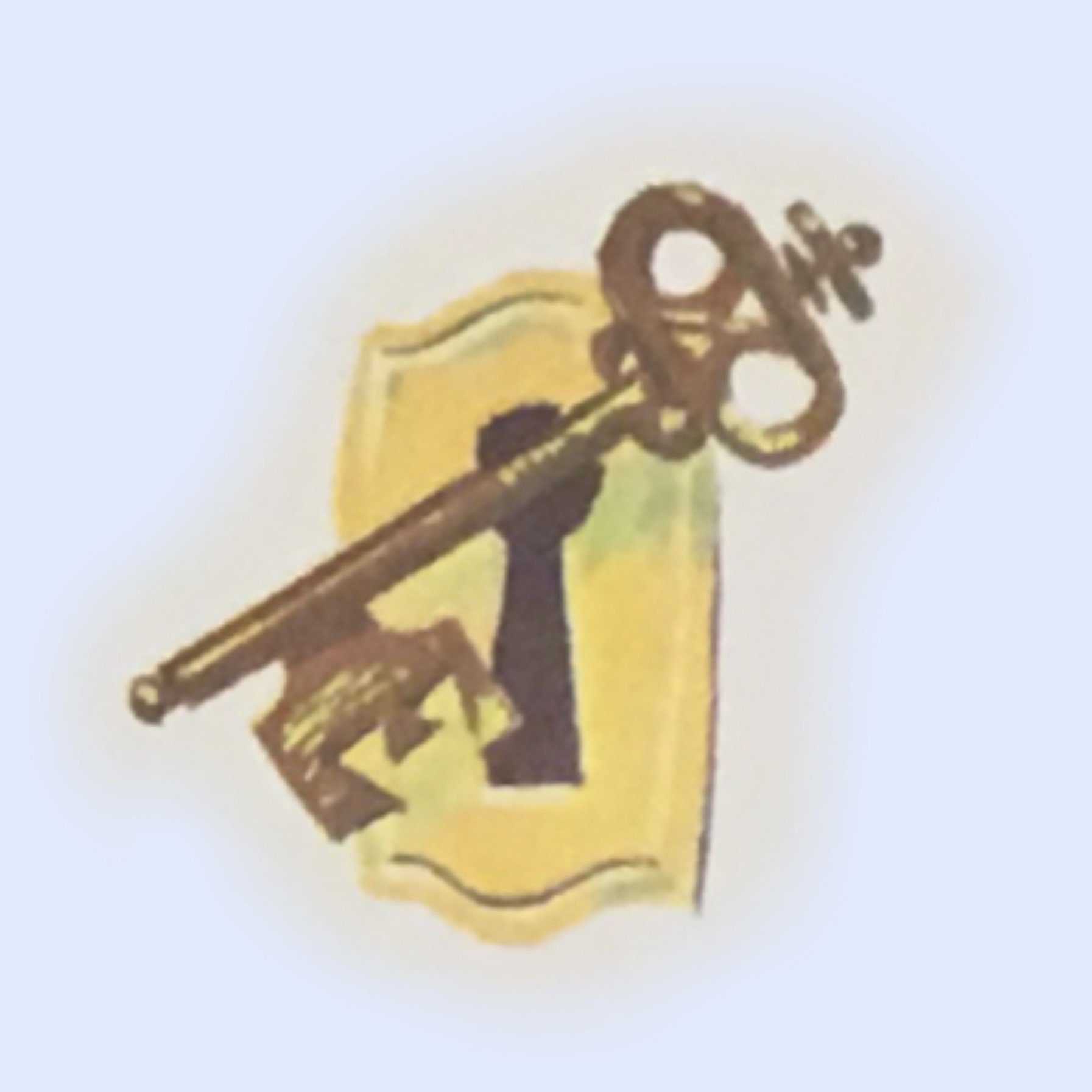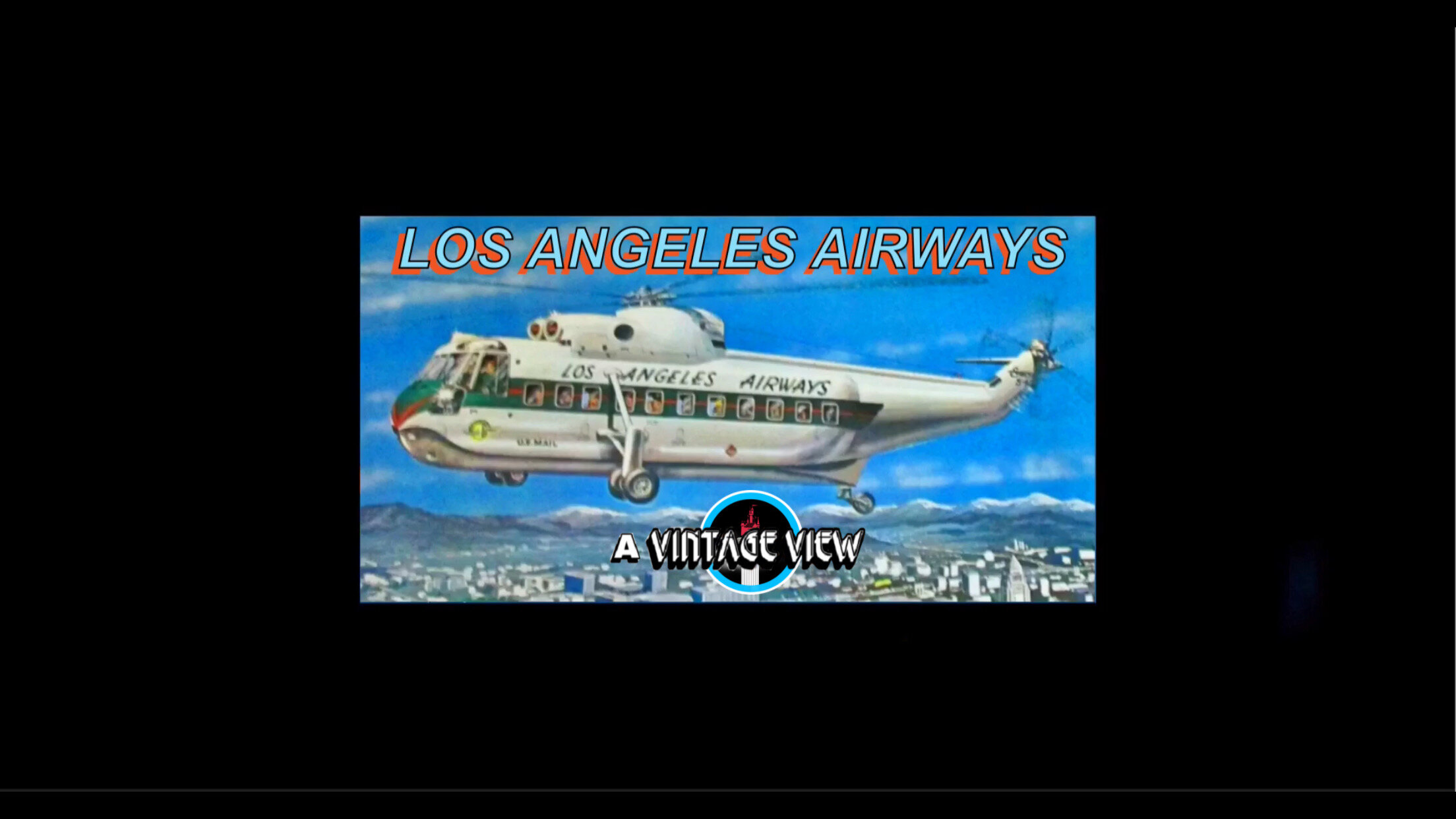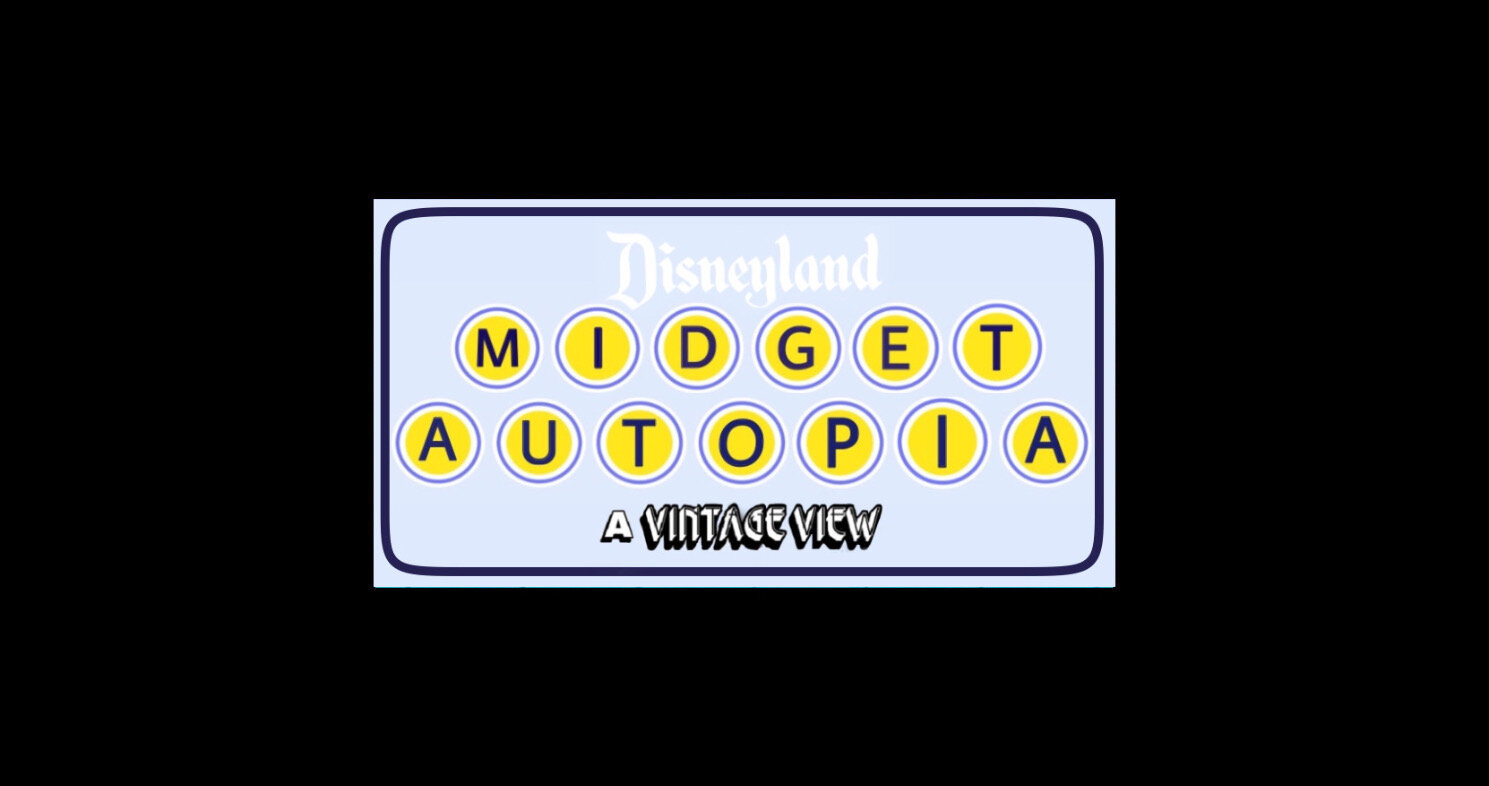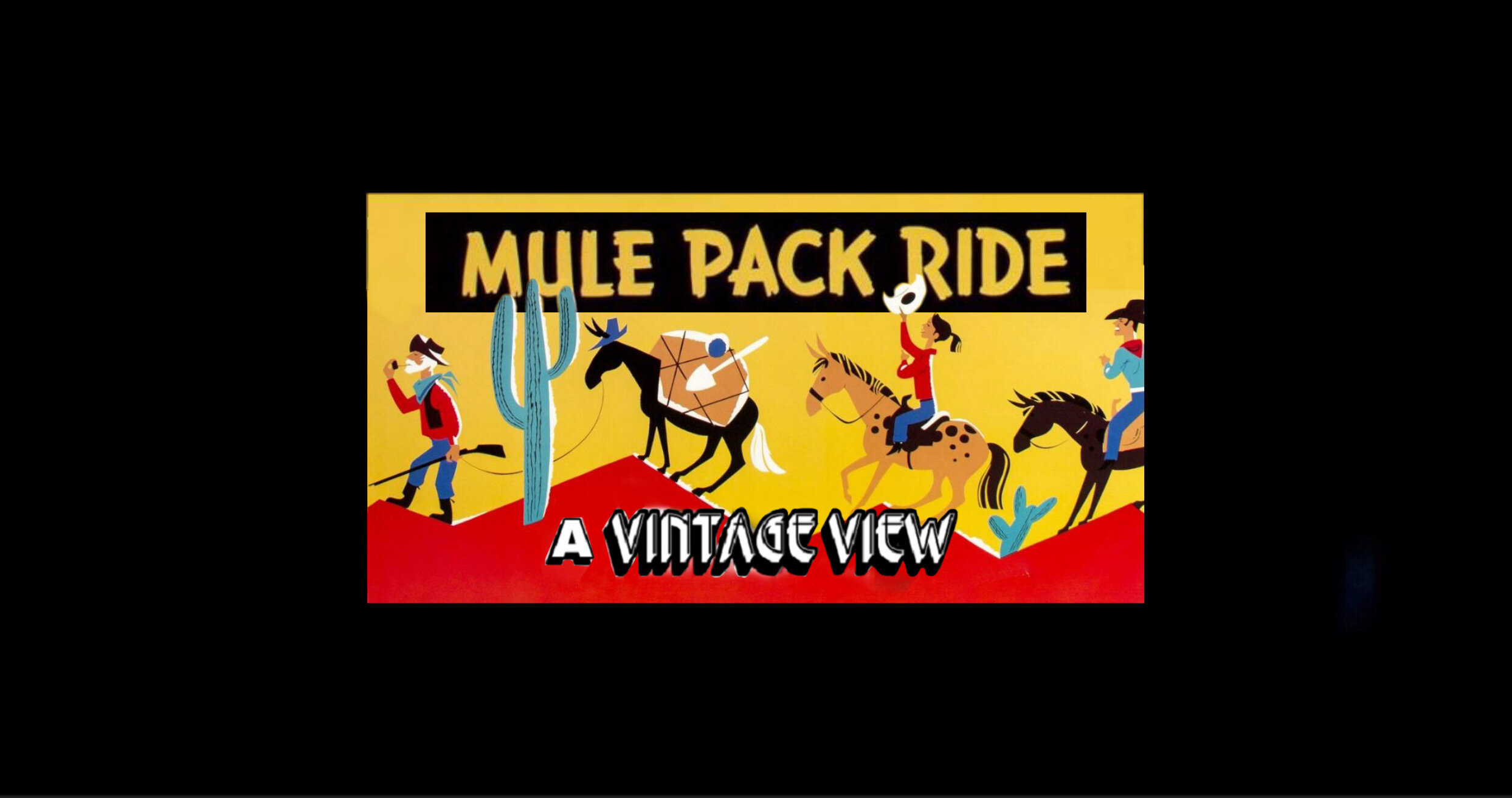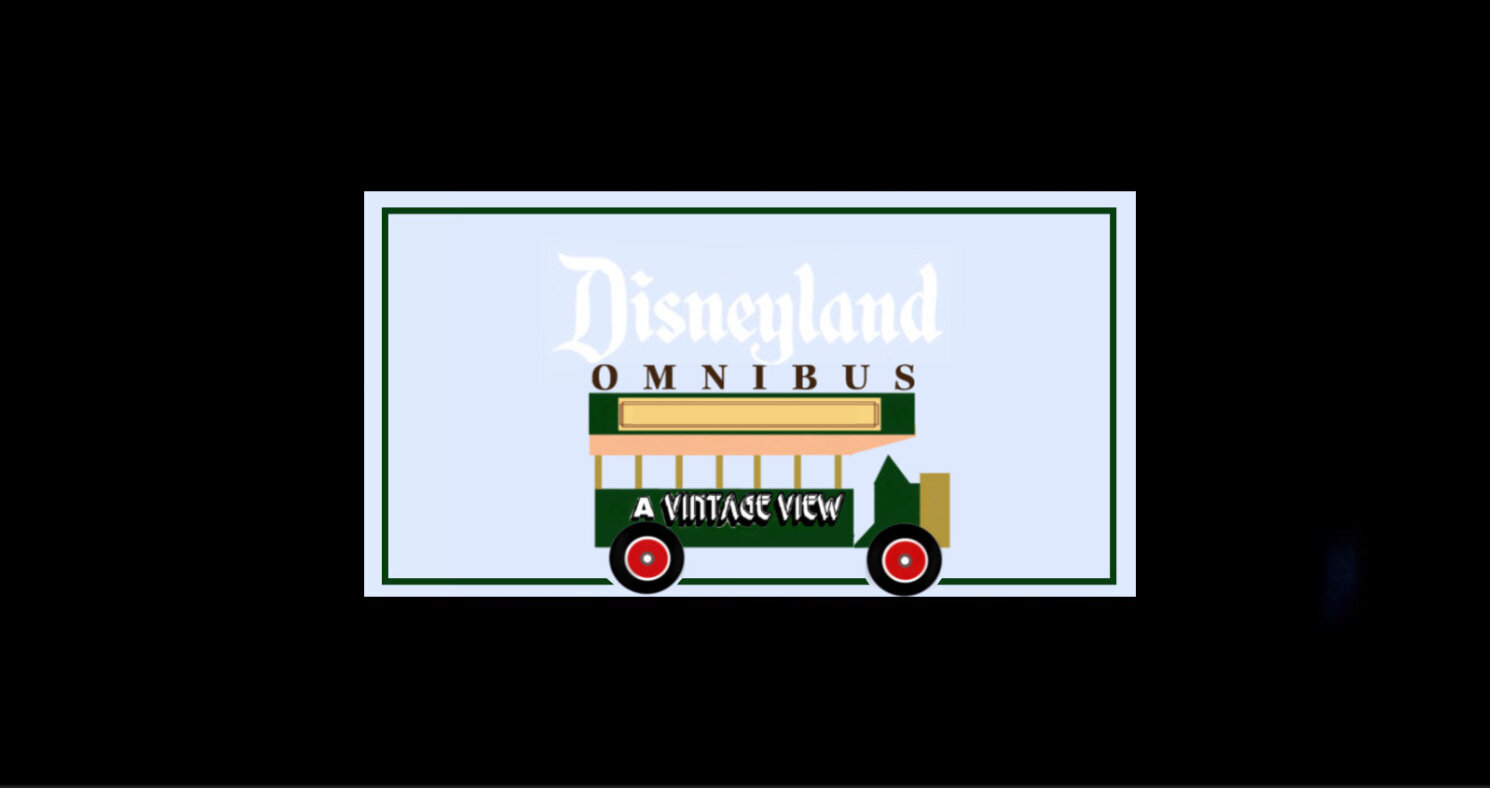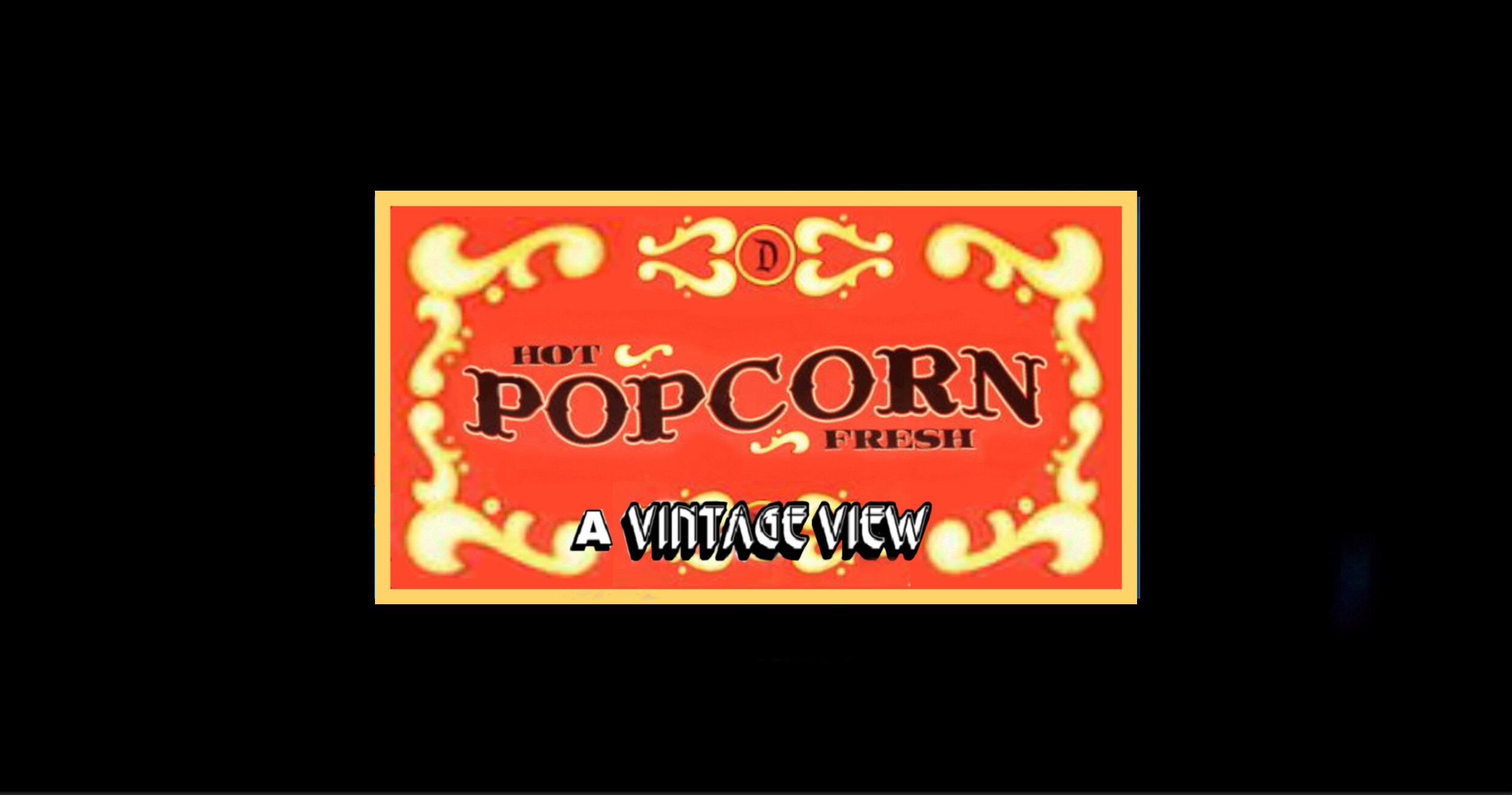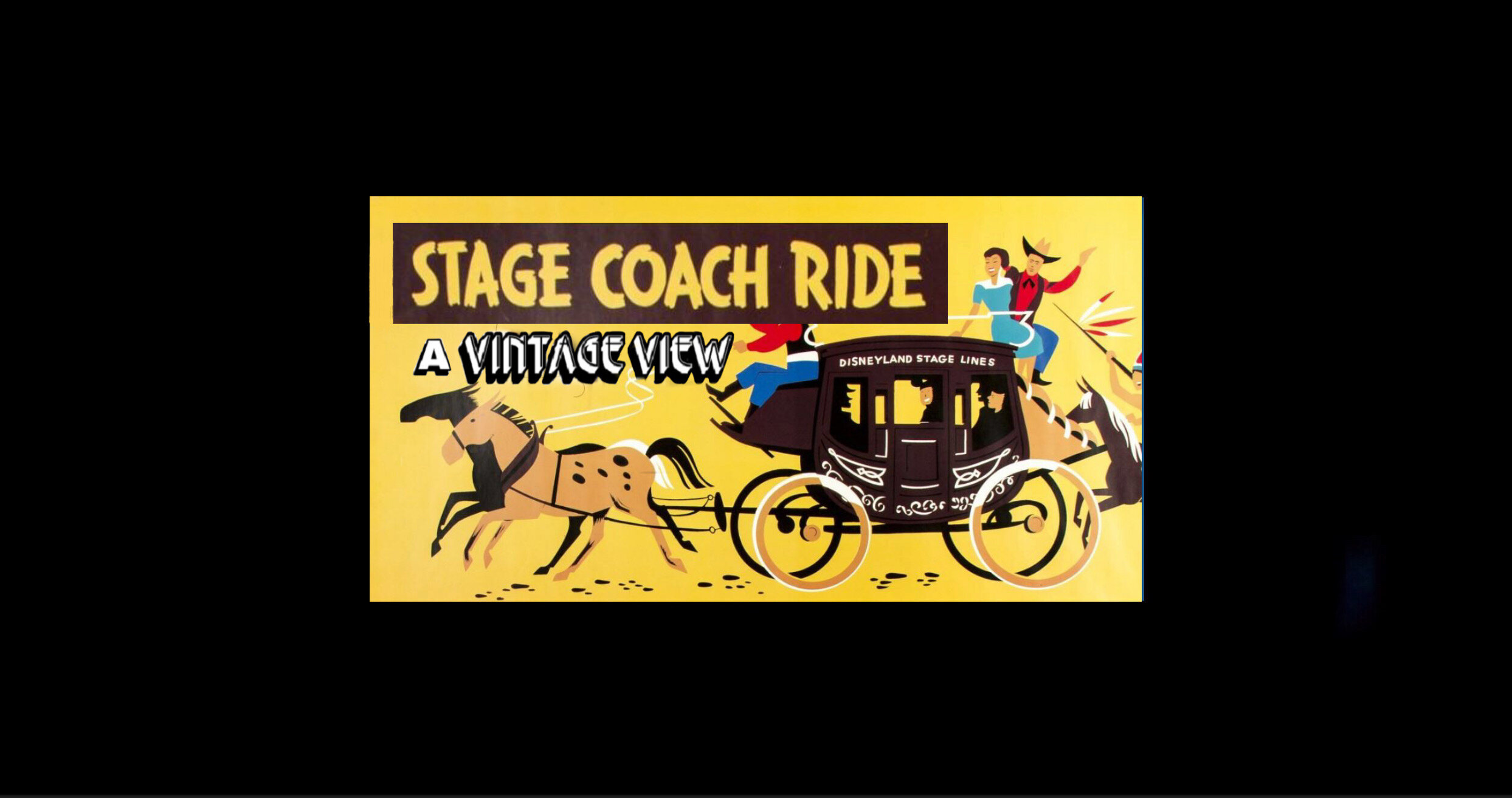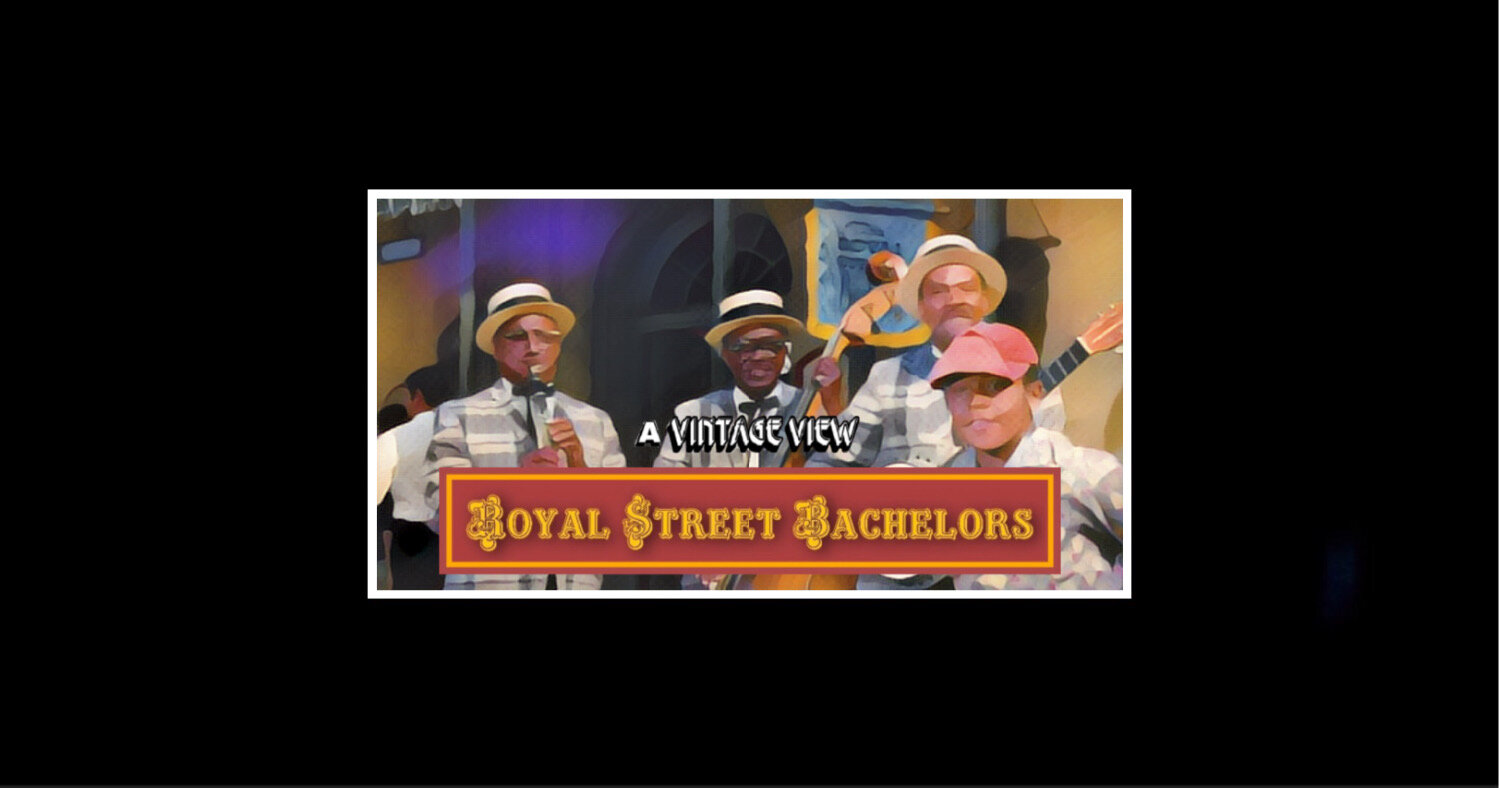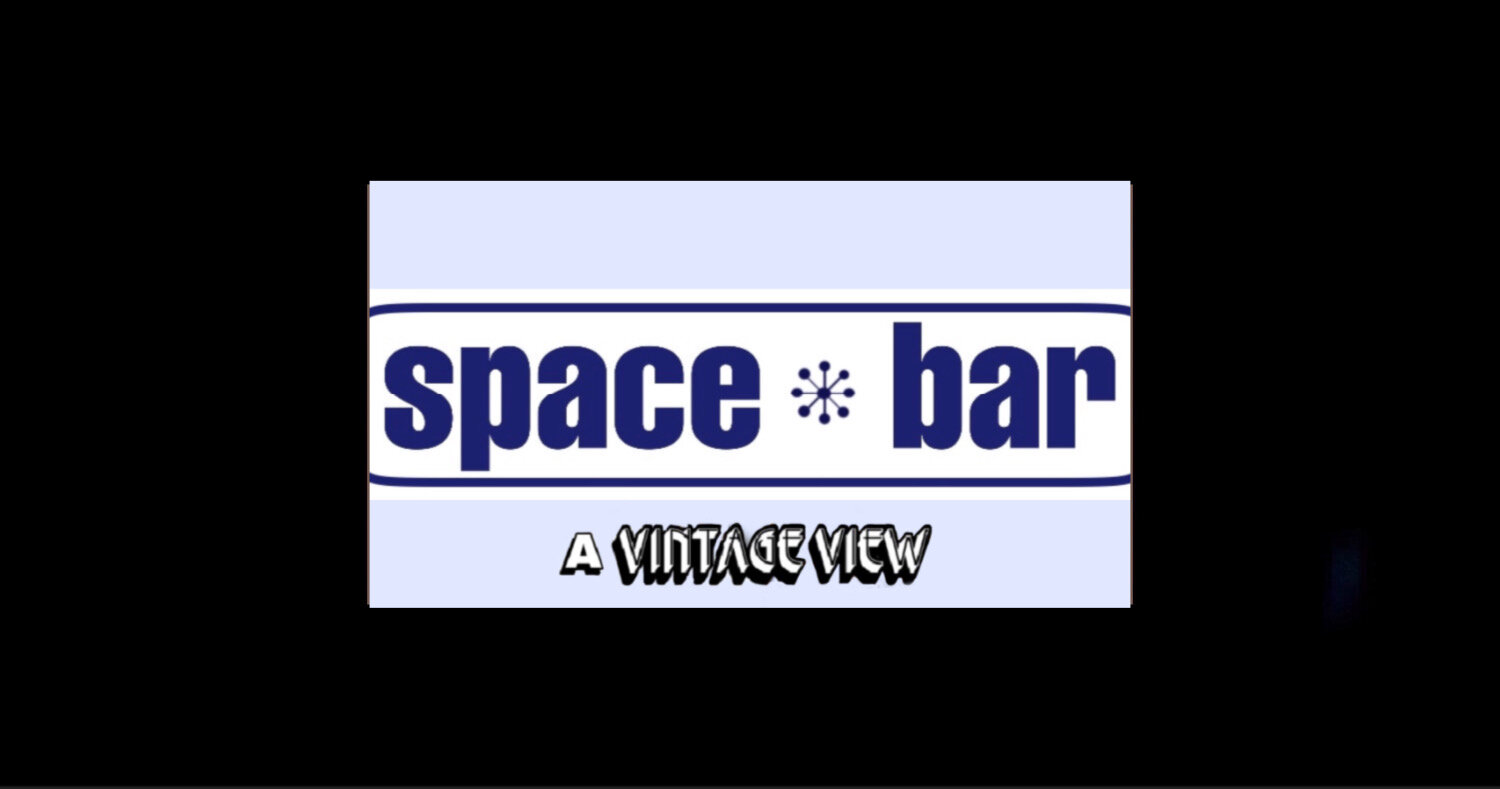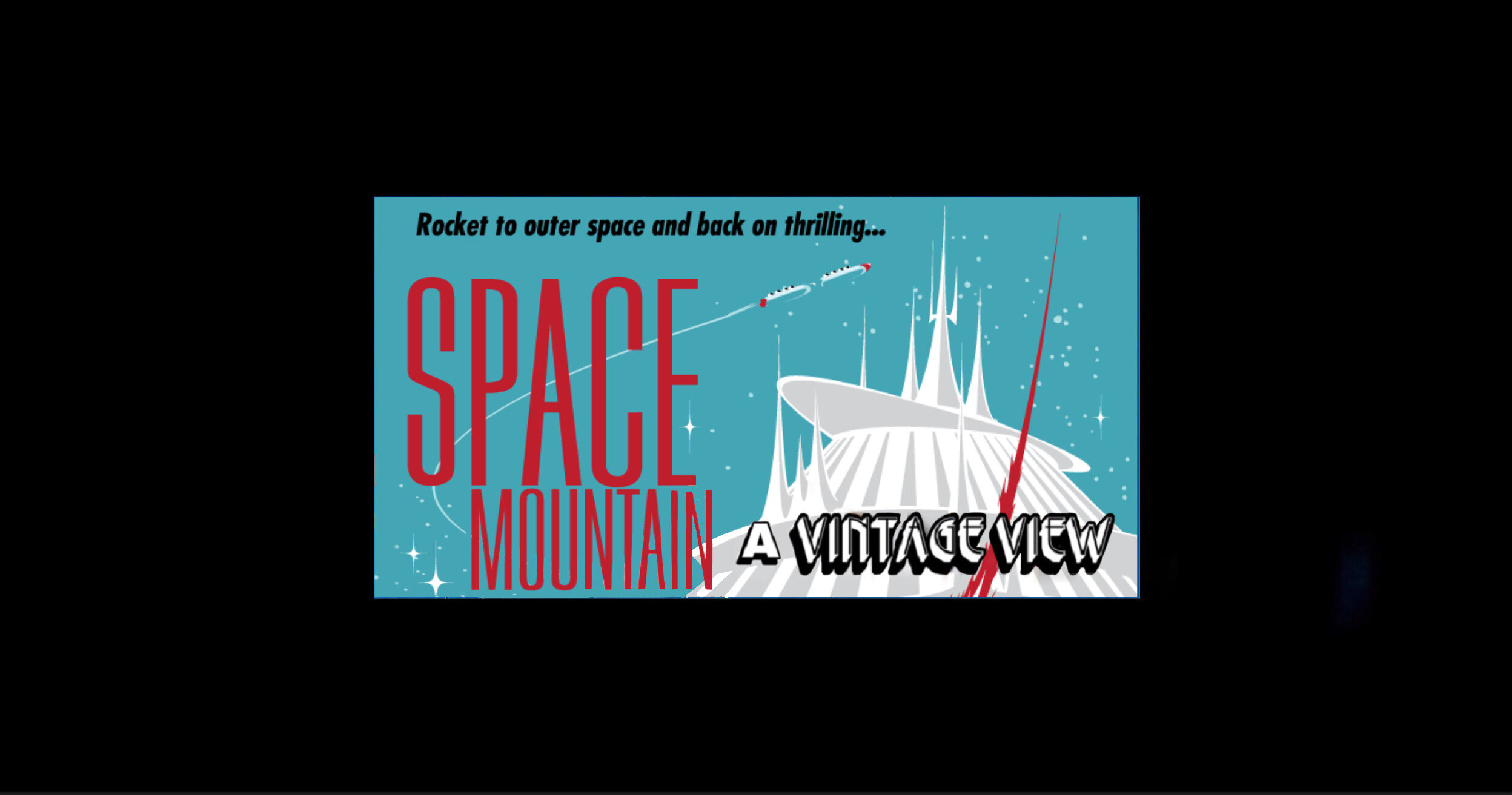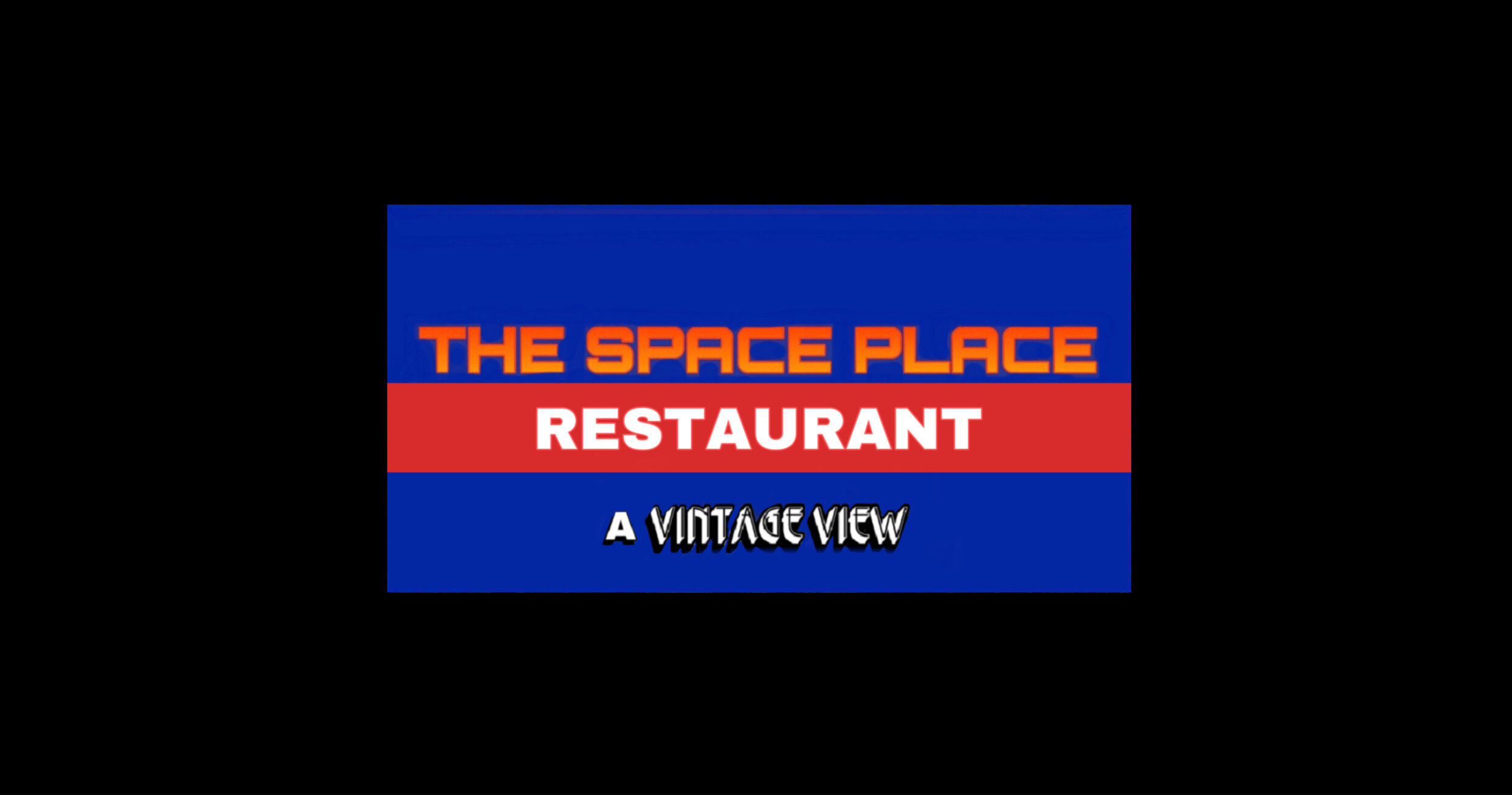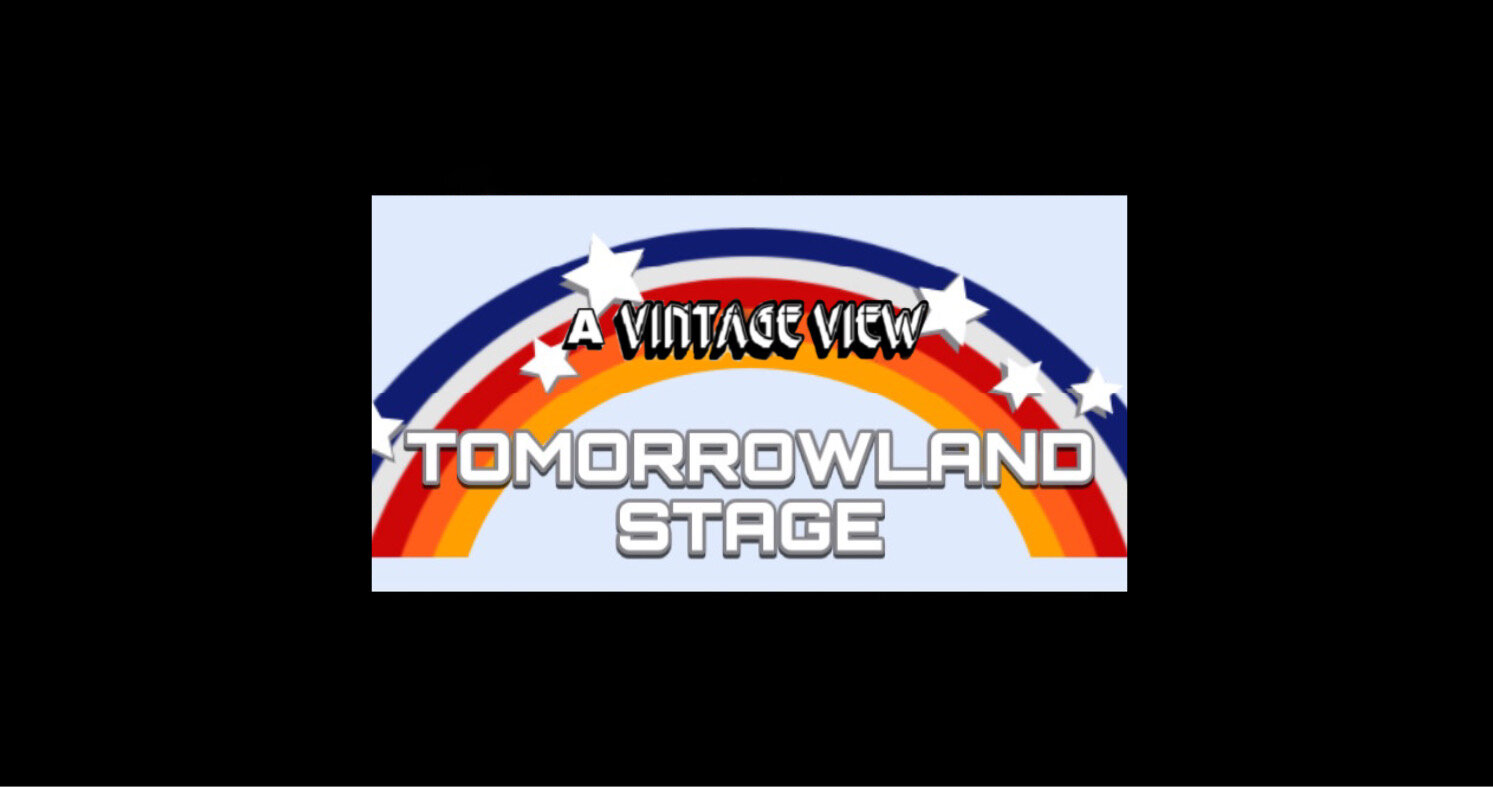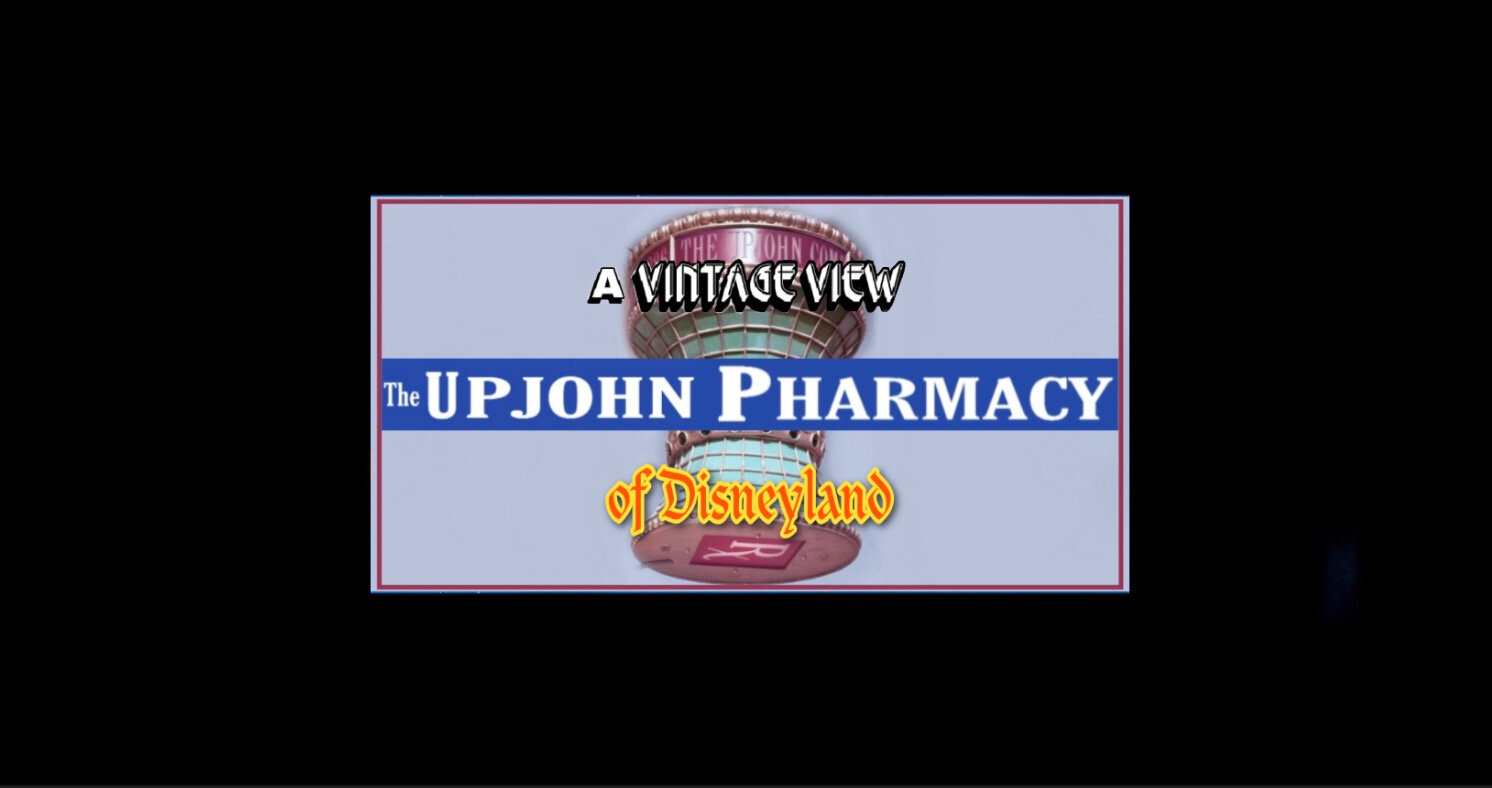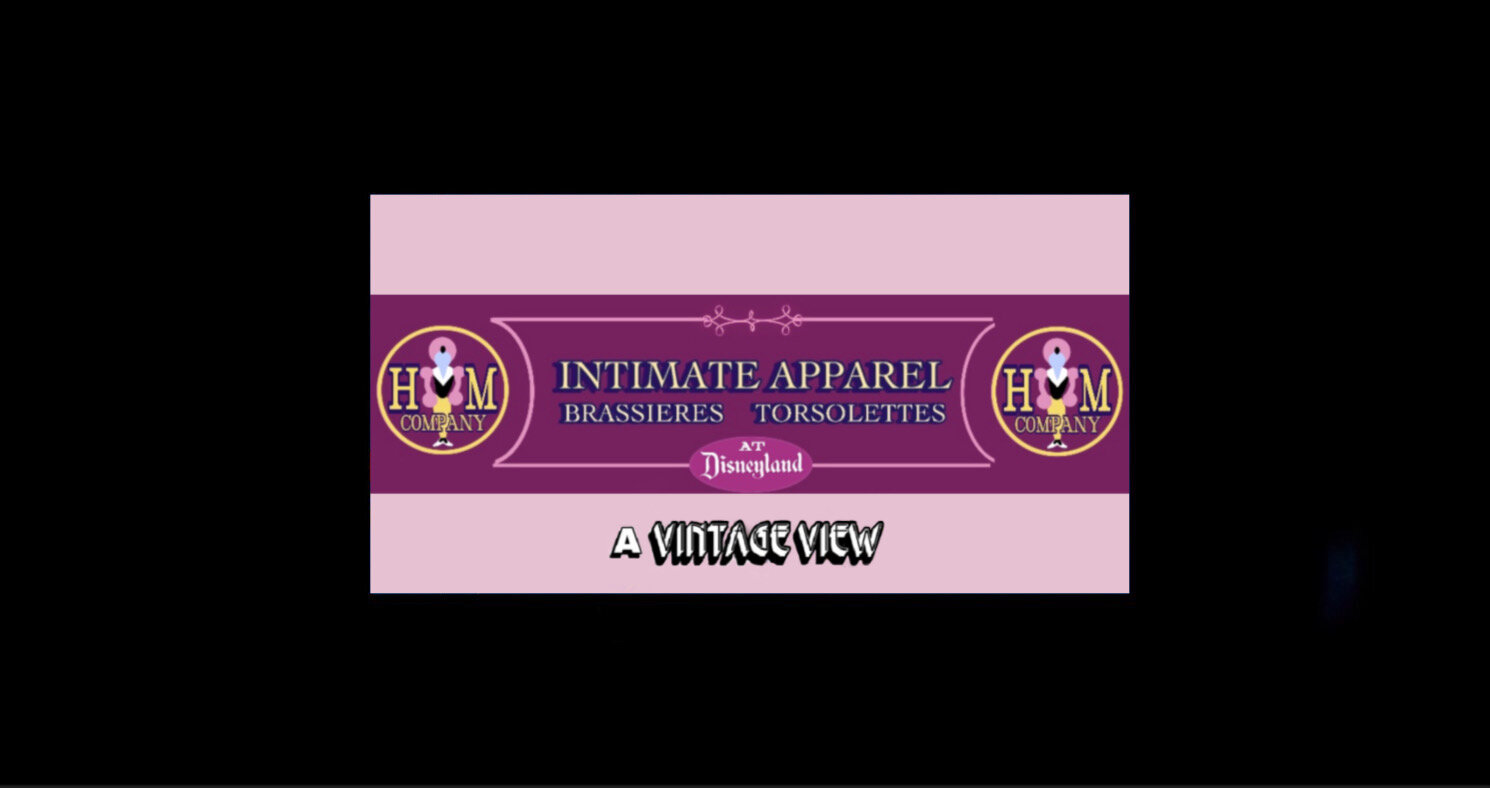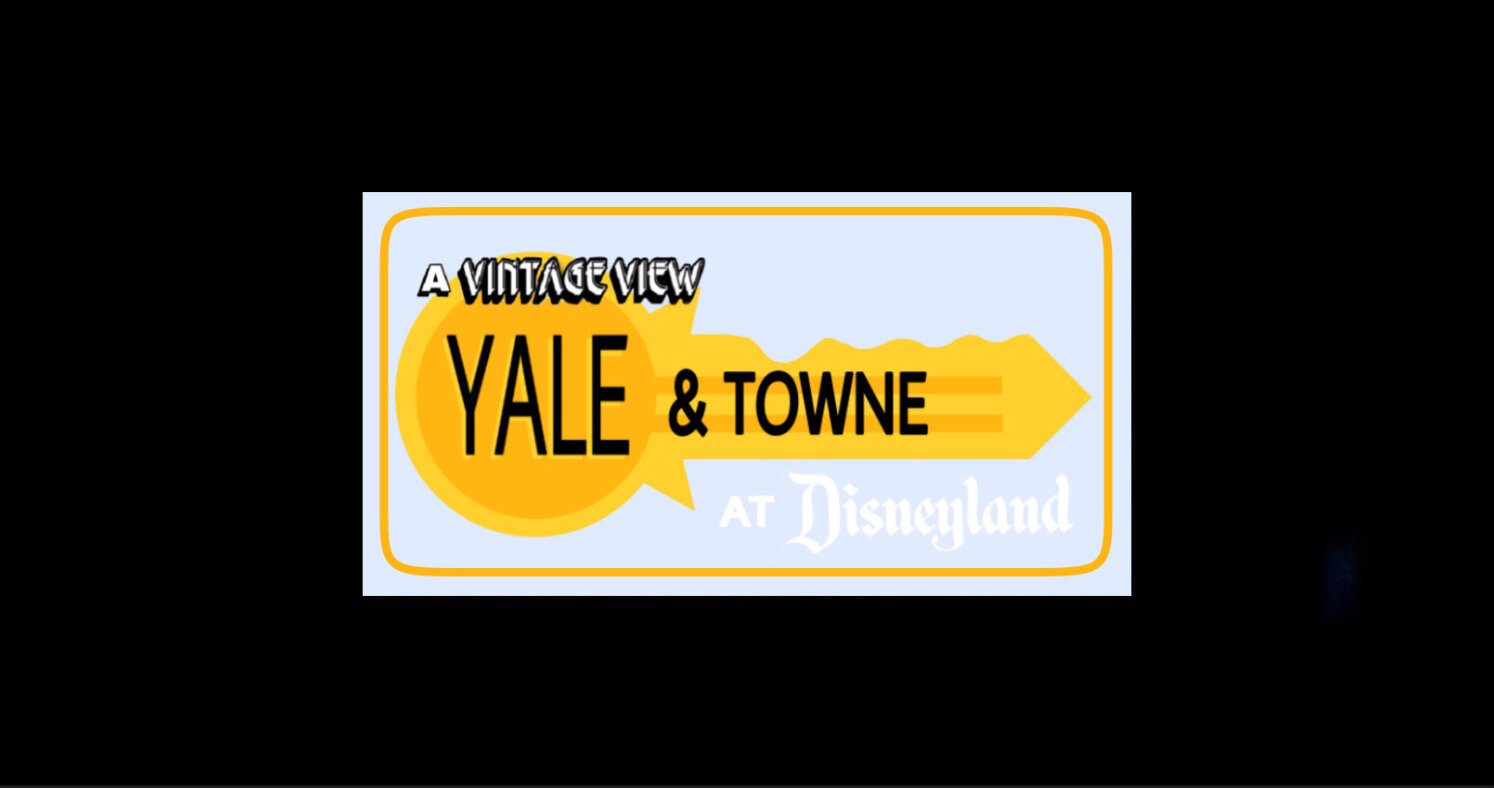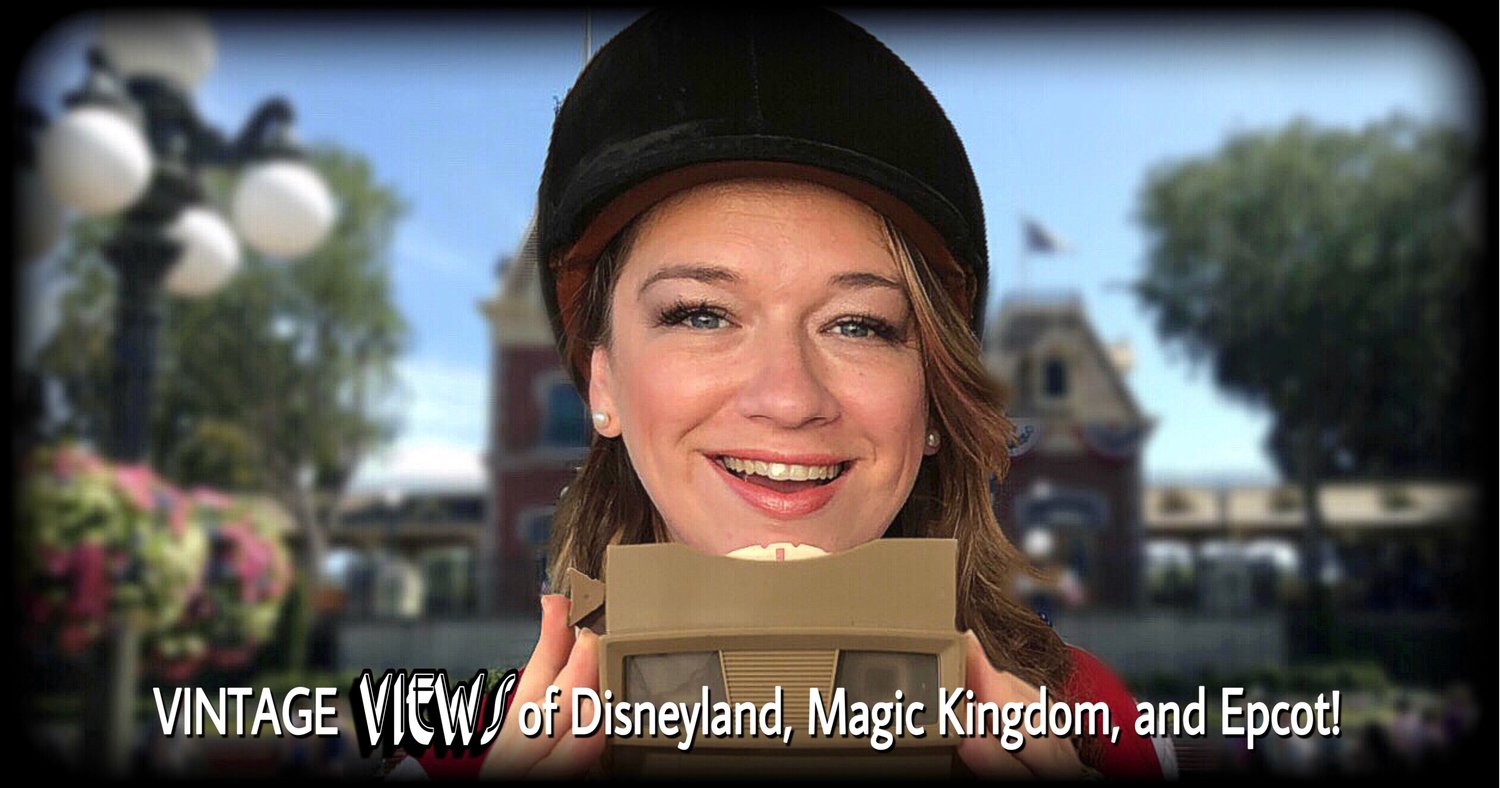LOS ANGELES AIRWAYS to DISNEYLAND
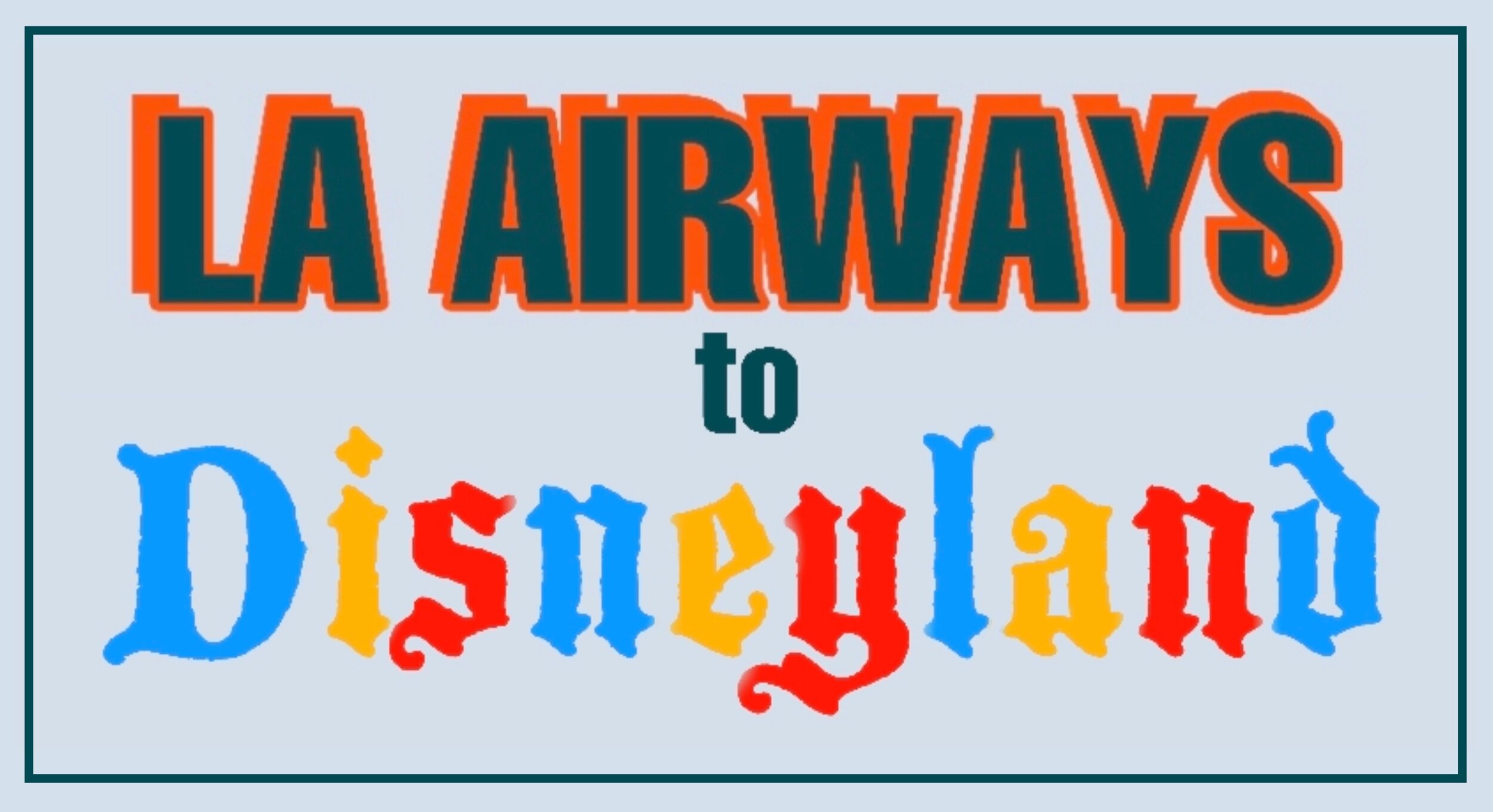
“A Fantasy In The Sky!”
In the beginning, the innovative Los Angeles Airways, Inc. started offering speedy mail carrier service with six brand-new Bell 47D helicopters on August 20, 1949. The company soon grew to provide roof-top delivery of air mail with new Sikorsky S-51 helicopters. By that time, they operated three routes serving some 30 communities within a 50-mile radius of Los Angeles Municipal Airport. The unusual airline saved from 4½ to 19 hours on daily air mail deliveries. In pioneering helicopter air mail delivery, Los Angeles Airways, Inc. provided an entirely new type of service that not only met the requirements of public convenience and necessity, but was tailored to the specific needs of the area it served.
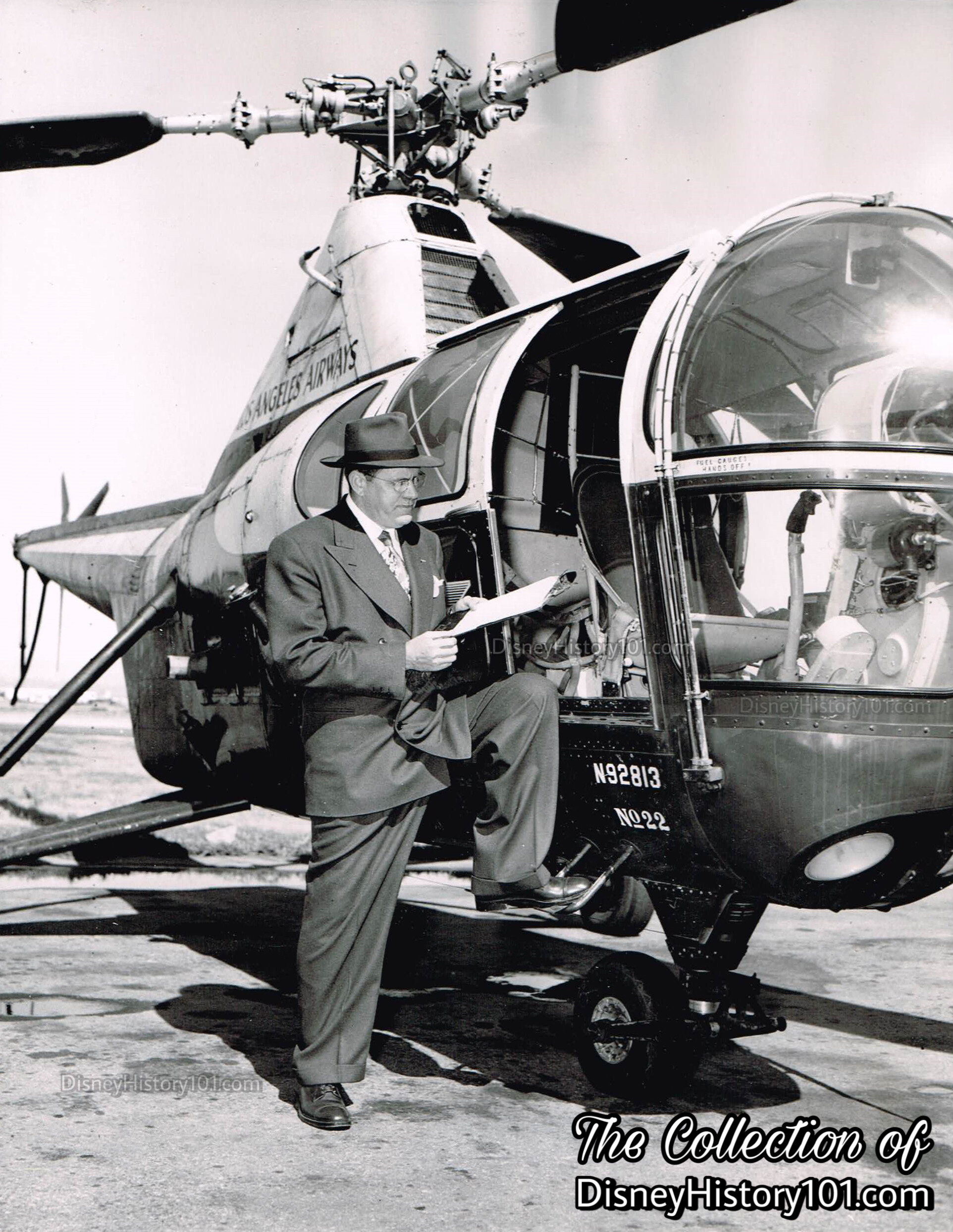
Pictured Above : This rare Vintage View was originally used to promote Los Angeles Airway’s upcoming passenger service, when the company was mainly a local mail courier service. The news of this reached other major cities, and one accompanying News caption (published in Cleveland, Ohio on March 30, 1951) read : “Clarence M. Berlinn, Head of Los Angeles Airways,which delivers Air Mail by helicopter in southern California, poses with one of his ships at Los Angeles International Airport. Belinn, who pioneered the “Eggbeater Mail” in this country, hopes to begin a helicopter passenger service in Los Angeles this summer.”
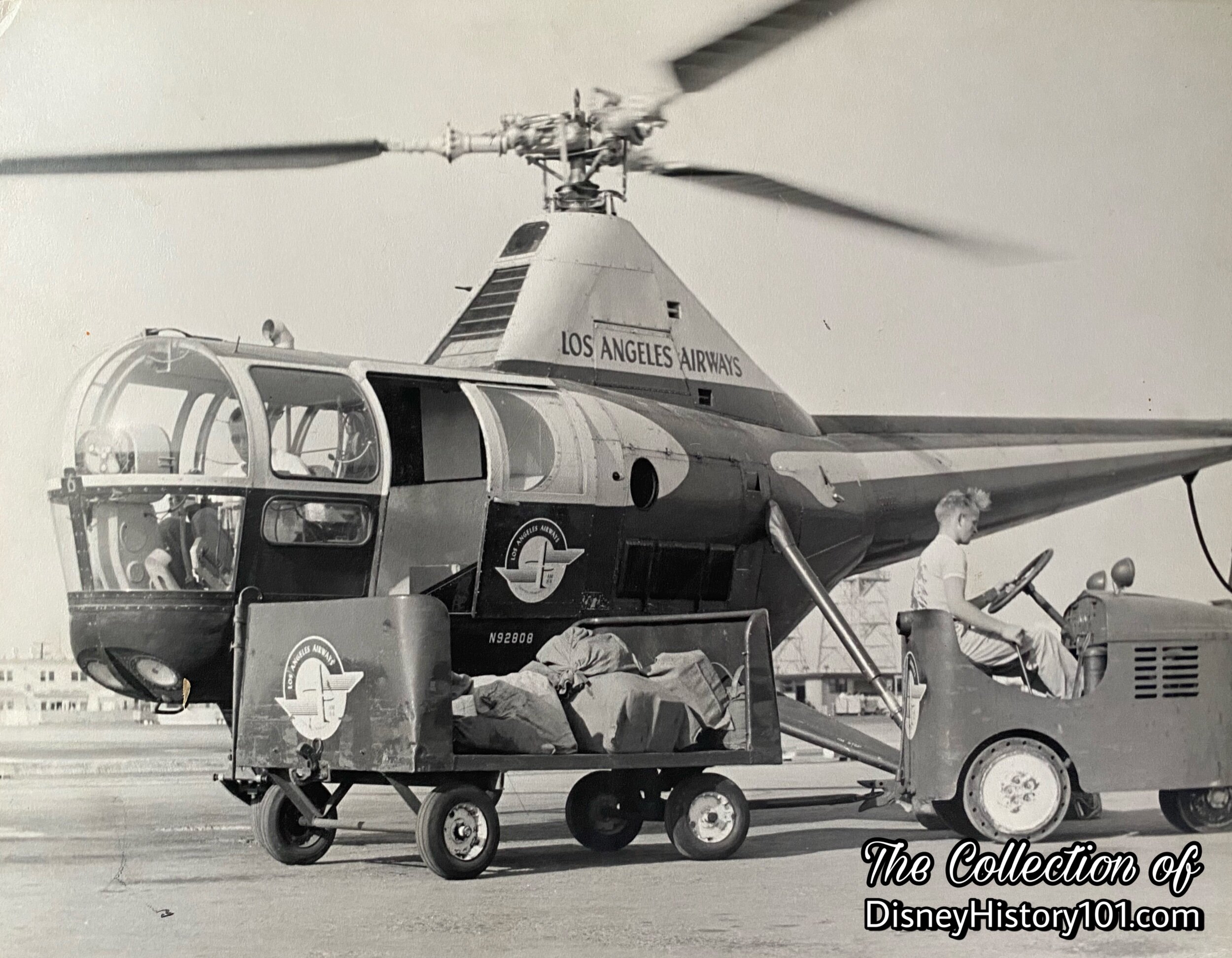
Operation costs were low, and by 1947 Los Angeles Airways (1947-1971) expanded their service in a whole new way to the Los Angeles County area! Yes, Los Angeles Airways became “the world’s first helicopter airline”, when it purchased and operated several of the first mass-produced civil helicopters - Sikorsky series S-51. The helicopters would link the civic center of Los Angeles with various metropolitan areas of Los Angeles County and Southern California area.
One of these destinations would carry passengers 27 miles southeast of Los Angeles to Anaheim, the "hub of happiness" and home to Walt Disney’s Magic Kingdom - Disneyland! Passengers could now travel the 40 miles across Los Angeles to Disneyland in less than 20 minutes. Yes, beginning on December 1, 1955, Los Angeles Airways made it most convenient for the “first time visitor” or local area residents to travel both to and from Disneyland!
At that time, Los Angeles Airways operated “four helicopter flights daily [except Monday in seasons when Park is closed Mondays] each way between Los Angeles International Airport and Disneyland’s own heliport, carrying 7 to 9 passengers. Direct on-ramp connections with TWA and other major airline flights. Through bookings from most U.S. and many foreign cities.” [“Information For Your Visit To Walt Disney’s Magic Kingdom Disneyland”, published 1955 by Disneyland Inc.]
By December of 1955, those four flights had expanded to include 12 arrivals and departures at Disneyland daily. According to The Disneyland News: “morning flights arrive at Disneyland from Los Angeles International every day except Sunday at 10 a.m., 4:45 p.m., 5:08 p.m. and 7:35 p.m. Sunday service is by two flights daily, at 1 p.m. and 7:35 p.m. Flights leave Disneyland for International Airport at 6:38 a.m., 10:03 a.m., 12:22 p.m., 4:48p.m. and 7:53 p.m. Sunday flights to the airport are at 1:03 p.m. and on the 7:53 p.m. helicopter.”
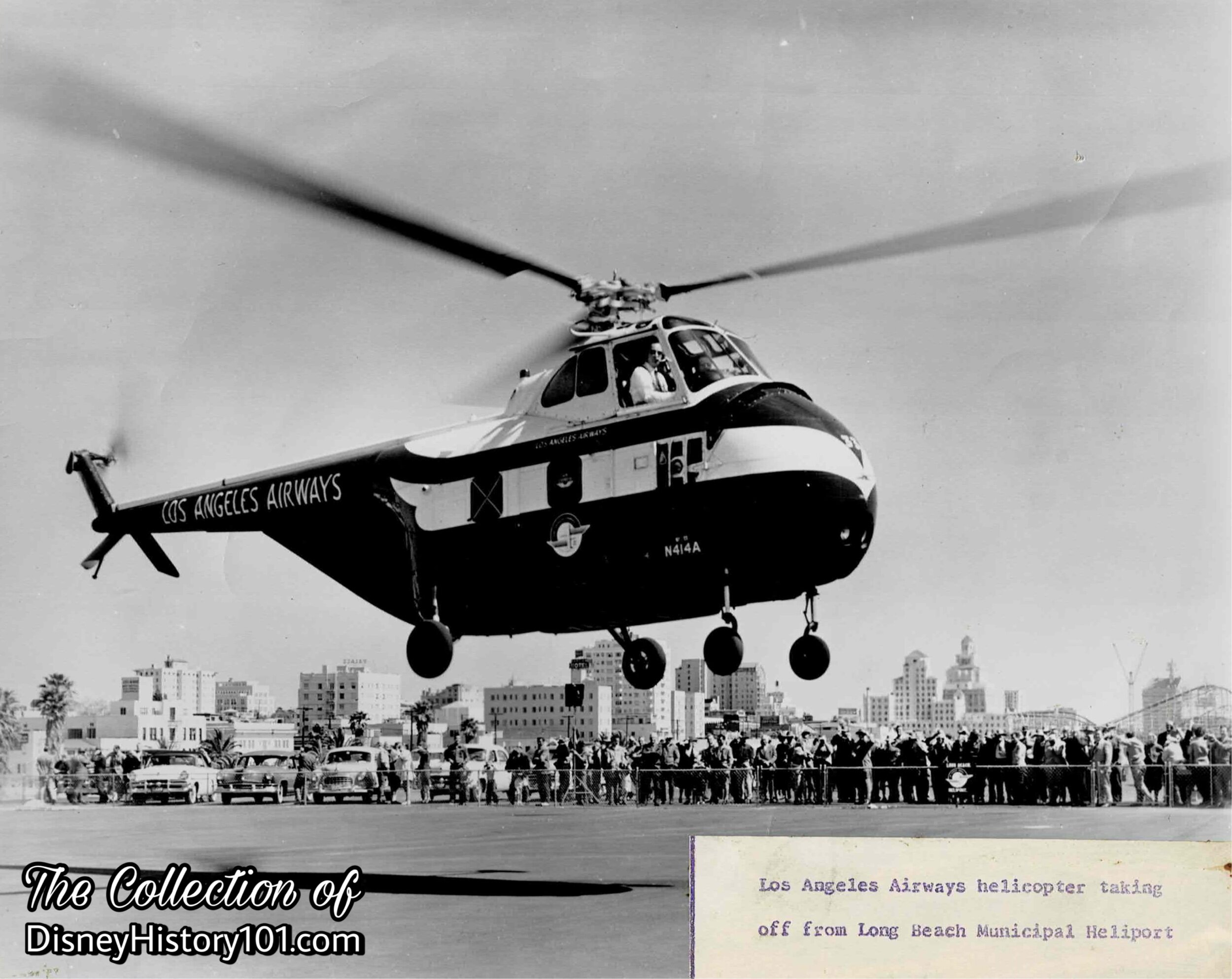
If you didn’t have an automobile, the typical local alternative was to board a Disneyland Motor Coach from Los Angeles to Disneyland. But Los Angeles Airways offered a more efficient (and scheduled) suburban airline service, with direct passenger connections between Los Angeles International Airport, and 20 direct Greater Los Angeles destinations including Disneyland Heliport! You know, some of the earliest Tomorrowland Rough Site Plan Drawings (as seen below) included a Helicopter Landing within the railroad tracks (and berm).
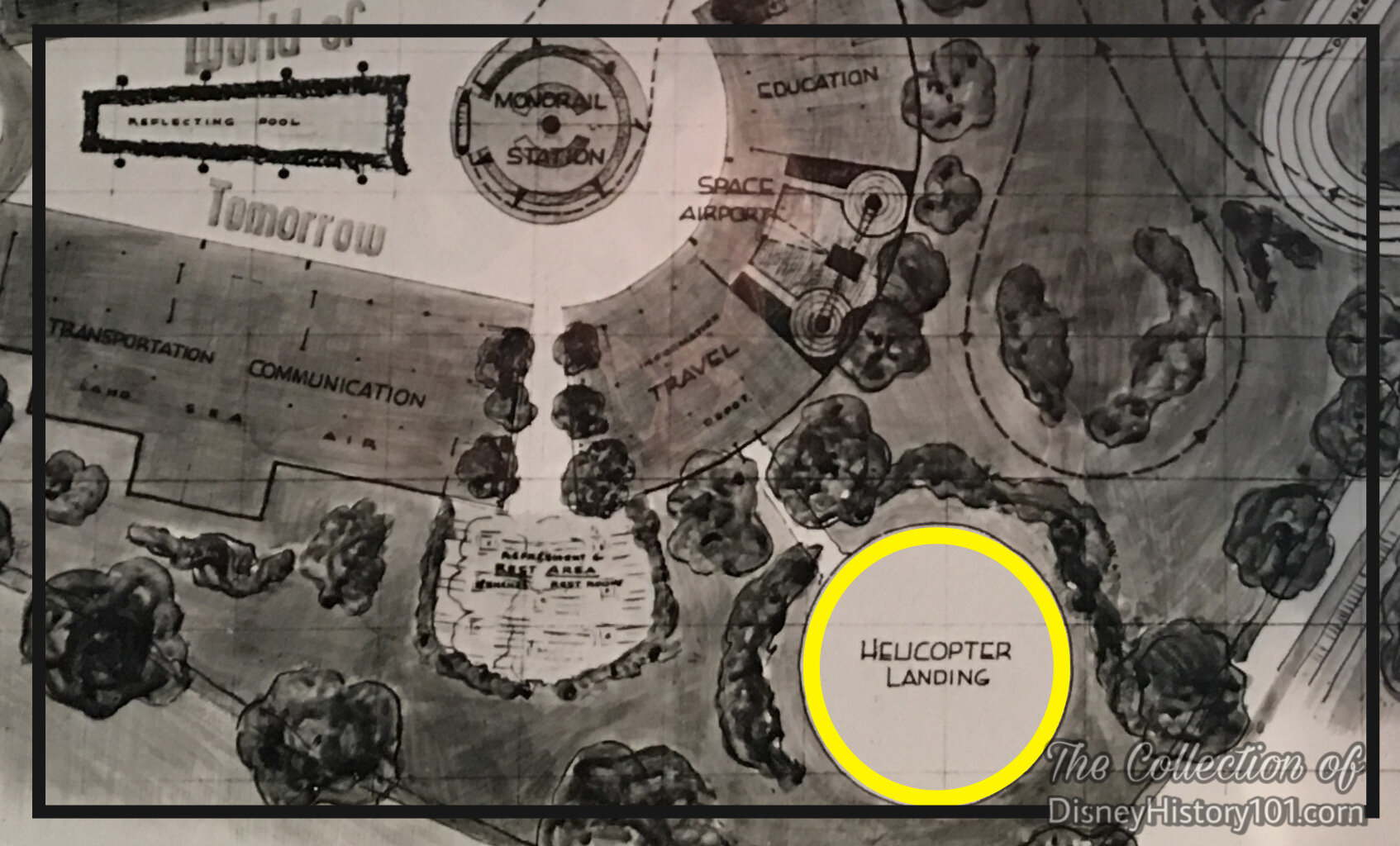
Because of site plans and drawings (like this one), many promotional materials and early licensed merchandise equated Tomorrowland with the sight of the helicopter.
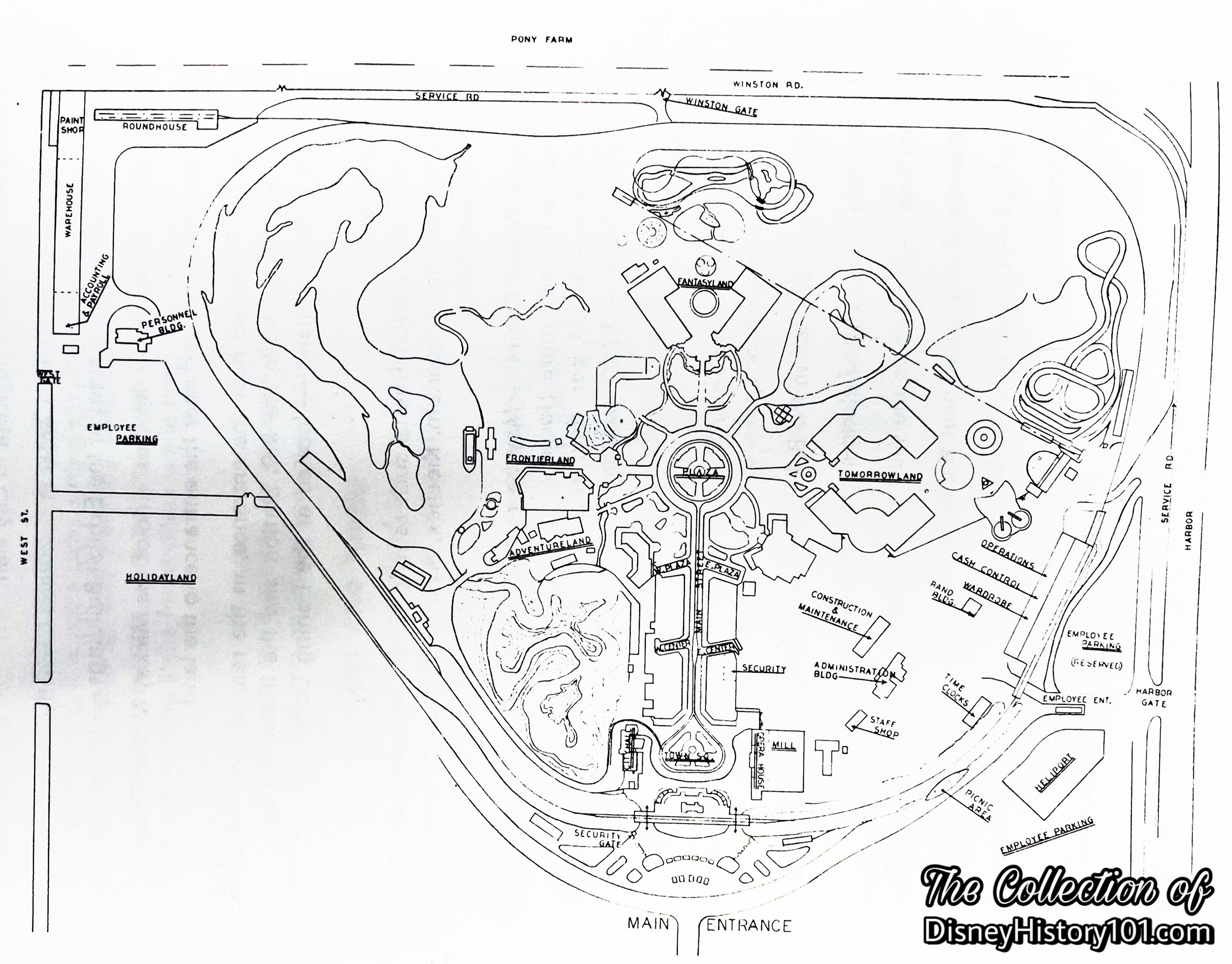
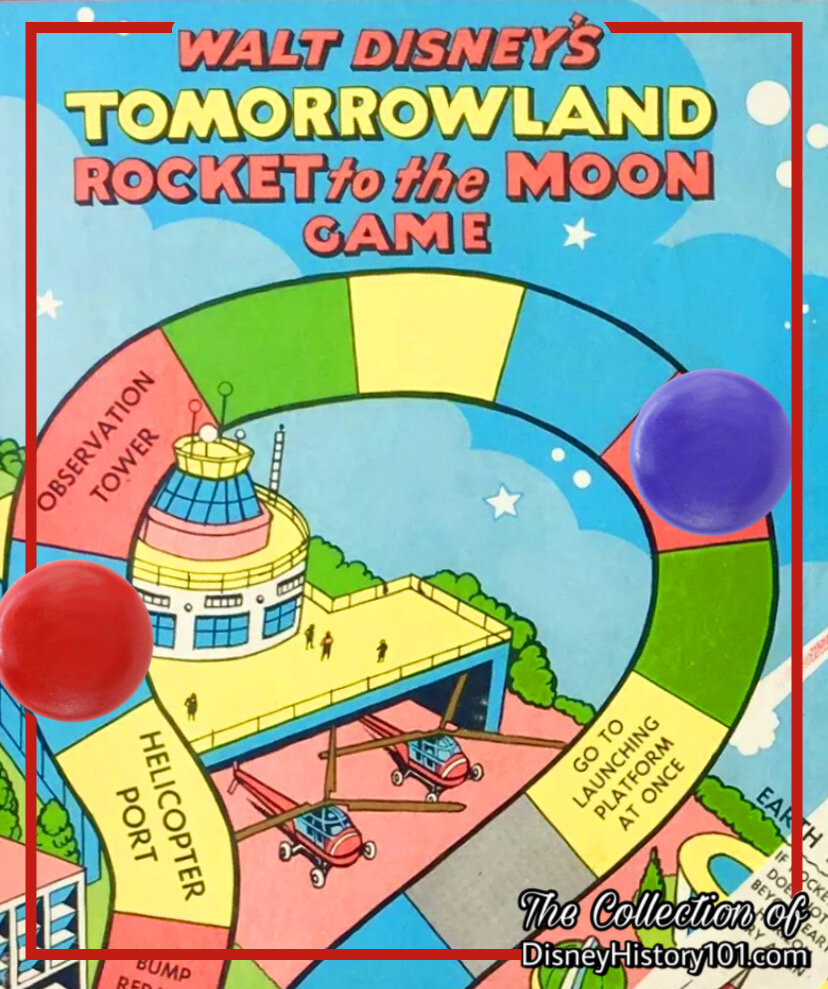
Helicopters were not viewed as visual intrusions over the future world of 1986. This early Tomorrowland merchandise (like this board game) seemingly implied that the “Helicopter Port” was a part of Tomorrowland.
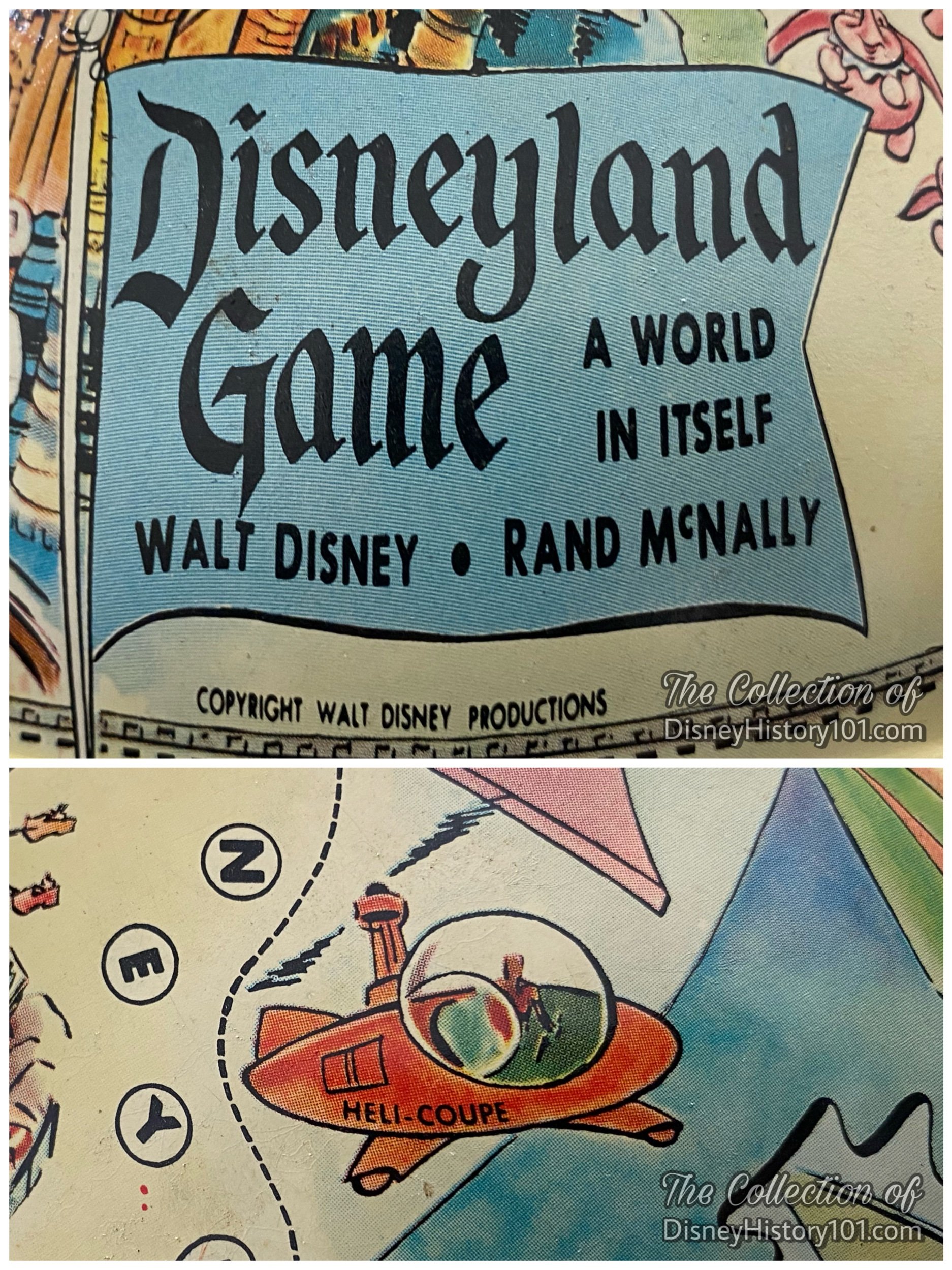
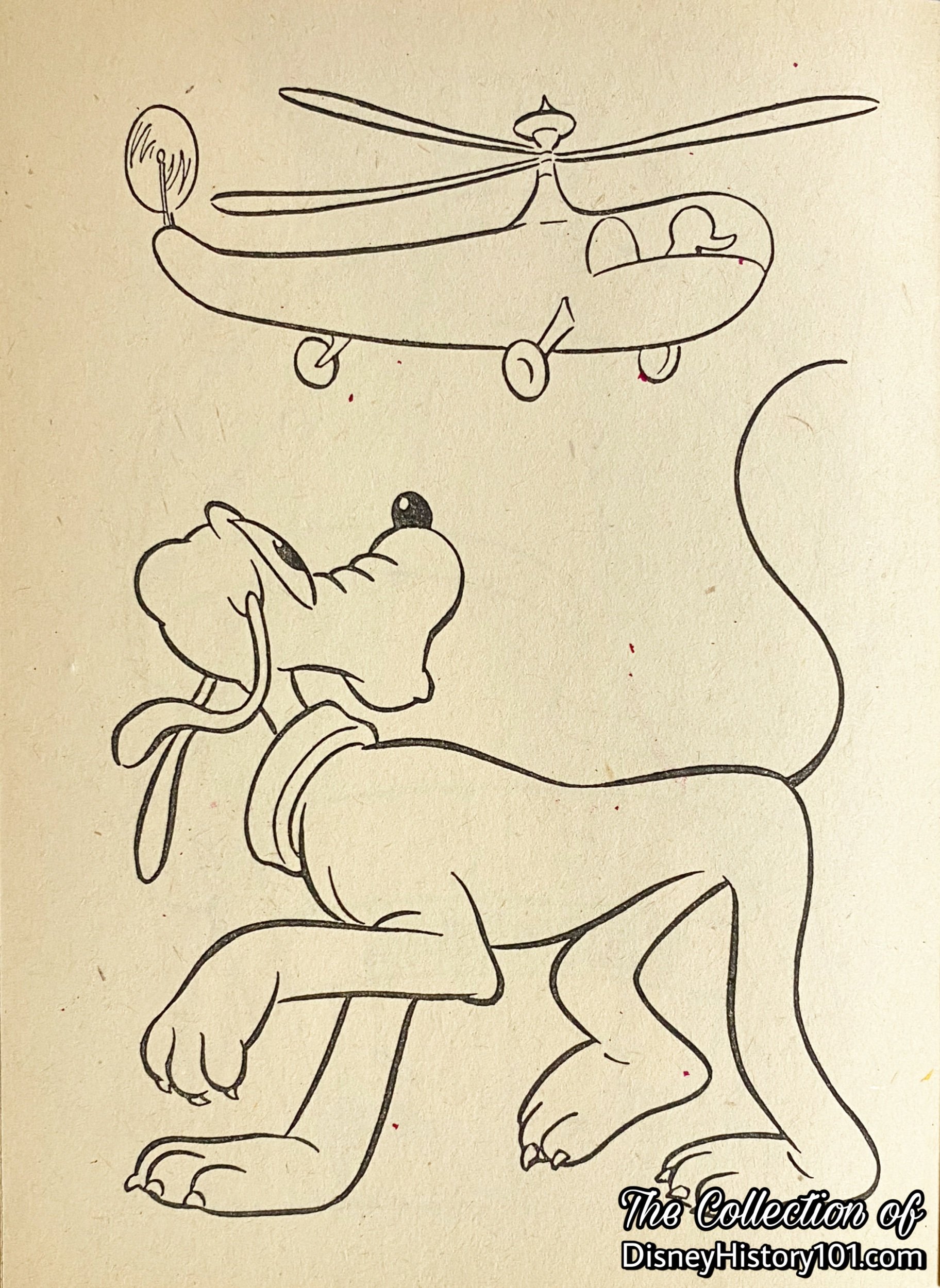

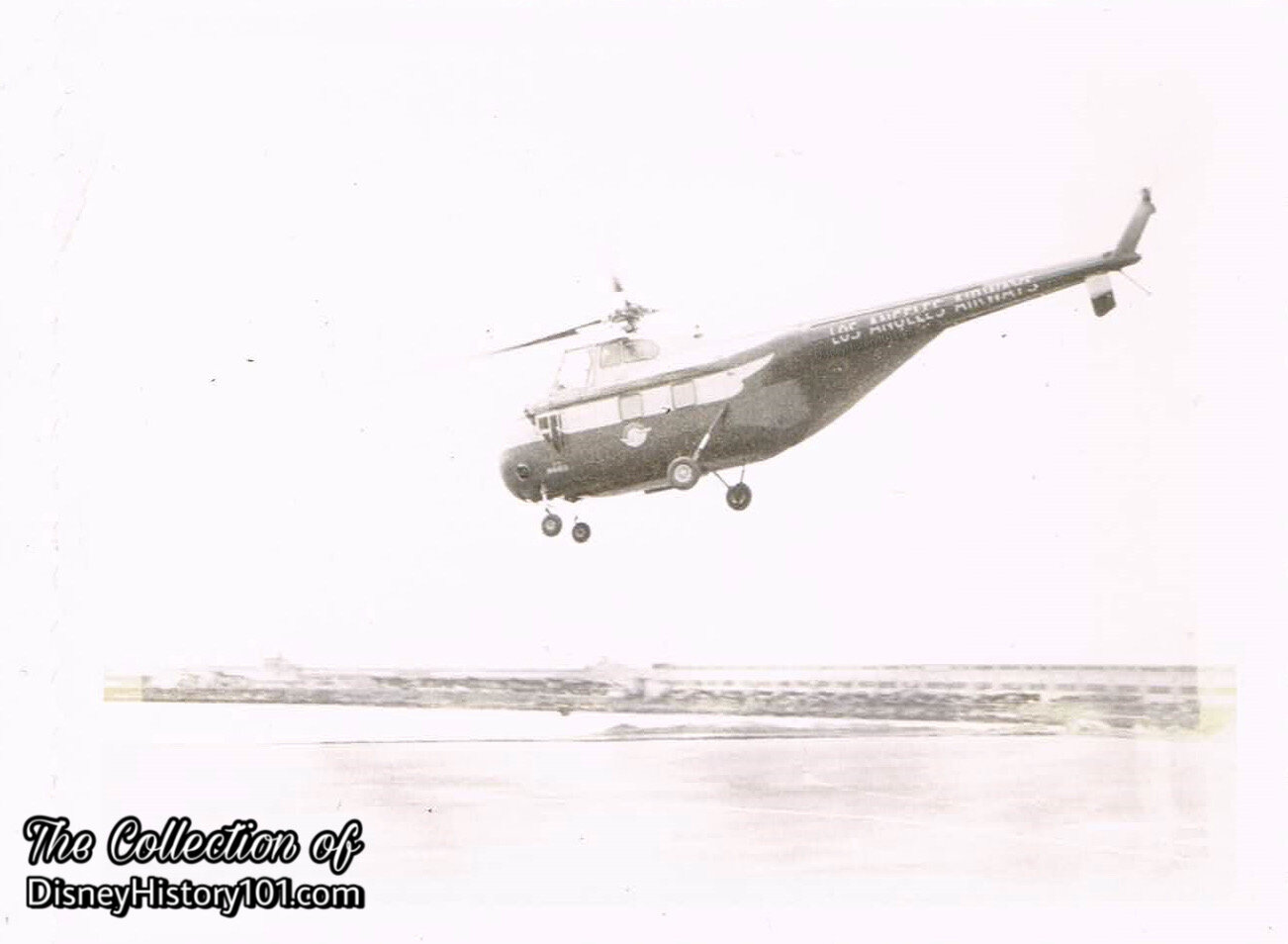
On “Dateline Disneyland” (aired July 17th, 1955), Art Linkletter mentioned, “Out this way, there’s a heliport, and actually, helicopters land there with their passengers from the International Airport.” He was (of course) referring to the first incarnation of Disneyland Heliport, located behind Tomorrowland. “News From Disneyland” (a press release document published c.1956) mentioned that “from Main Street Station you’ll look out over the 100-acre parking lot and the heliport” (indicating both its proximity to the parking lot, and visibility from inside the Park). This was where the Los Angeles Airways S-55 commercial Sikorsky helicopters (similar to the ones in the preceding photo) would land, during the first few years of operation.
Of course, the new service would go into effect since December 1, and gave Disneyland 12 arrivals and departures daily. Flight times were coordinated to make connections with maior cross country and coastwise airline flights. Morning flights would arrive at Disneyland from Los Angeles International every day except Sunday at 10 a.m., 4:45 p.m., 5:08 p.m. and 7:35 p.m. Sunday service was by two flights daily, at 1 p.m. and 7:35 p.m. Flights would leave Disneyland for International Airport at 6:38 a.m., 10:03 a.m., 12:22 p.m., 4:48 p.m. and 7:53 p.m. Sunday flights to the airport would start at 1:03 p.m. and on the 7:53 p.m. helicopter.
At the Grand Opening of the Disneyland Hotel (in 1956), the new Disneyland Heliport (west of Disneyland Park) officially opened! The Disneyland Stamp Book (published 1956) featured a collectable stamp picturing one of these very Sikorsky models landing at the new Disneyland Heliport! The new Disneyland Heliport (at the Disneyland Hotel) and of these Sikorsky’s can also readily be seen preserved on film, as it lands, in “Disneyland, U.S.A.” (a “People and Places” feature film, released in the U.S. on December 20, 1956 through Buena Vista Film Distribution Company).
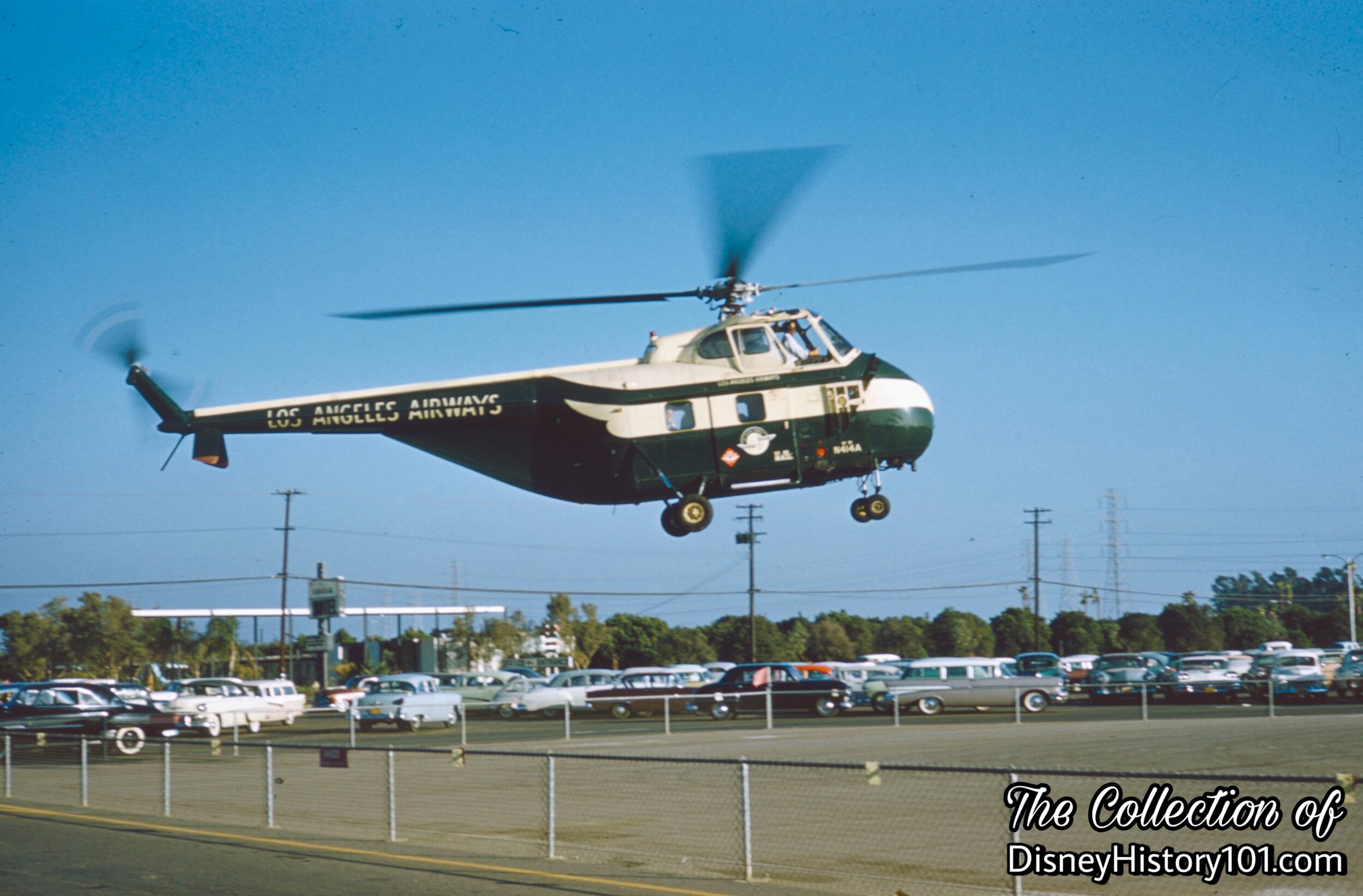
Los Angeles Airways was by-far the classiest, fastest, and safest way to travel from LA to Disneyland (for instance, during 1955, Los Angeles Airways was the first certified airline to take the liberty of outfitting their new S-55s with windshield wipers). Sikorskys also bore a unique rotor configuration, which has become a standard in the aviation industry. Walt Disney himself believed much in Los Angeles Airways and their top-notch fleet, that he personally endorsed Los Angeles Airways, by riding as a passenger aboard one of their Sikorskys (N736A) from Los Angeles to Disneyland as far back as 1955! By Disneyland’s 1-year anniversary in 1956, the Official Guide to Disneyland announced that “airline tickets can be bought from any place in the world direct to Disneyland. . . five helicopter flights arrive daily at the Disneyland Heliport.” “The Disneyland News” (Vol.2, No.2 ; August, 1955) ran an advertisement for “the fast, convenient way to Disneyland… only 20 minutes.” The following year, another advertisement (published in Disneyland Holiday magazine ; Spring, 1957) continued to herald the, “Fast, Convenient, Only 20 Minutes to Disneyland”! Guests need only consult individual companies for information and time schedules.
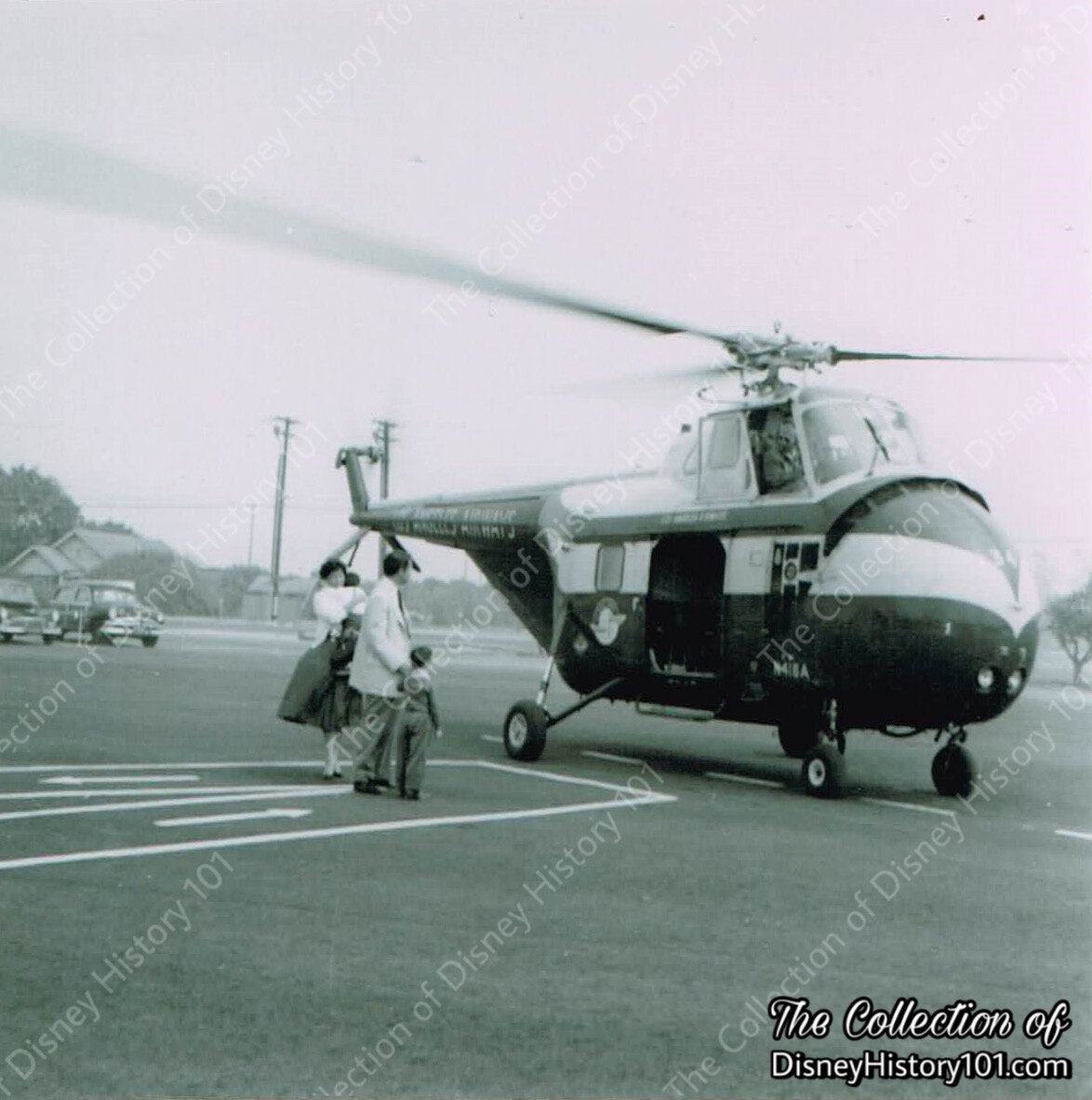
Here, highly decorated U.S. combat soldier Audie Murphy and family board a Los Angeles Airways S-55 at Disneyland Heliport in 1956, preparing for a twenty-minute trip at the end of their day at Disneyland.

In 1957, even Uncle Scrooge flew his McDuck Airlines Helicopter to Disneyland, landing at the Disneyland Heliport.
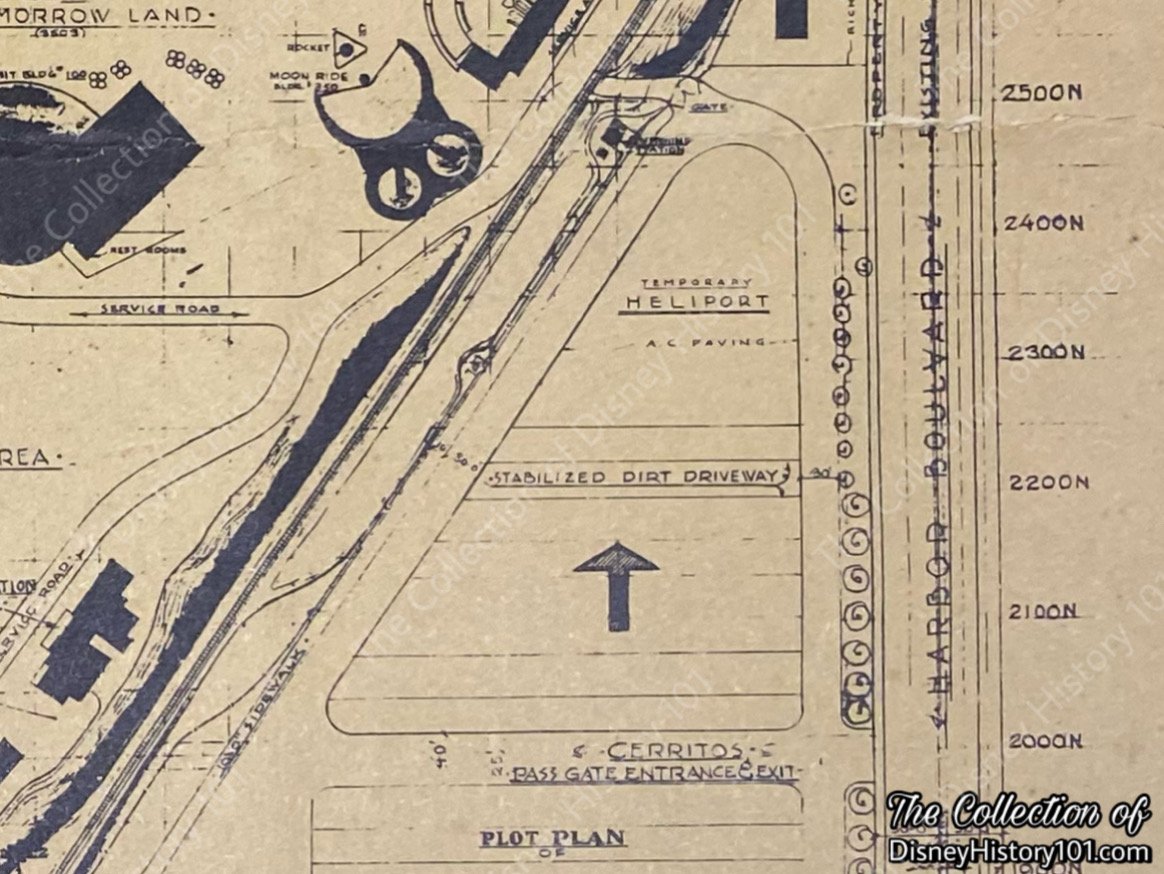
In these early days, the helicopter pad (or, “Heliport”) was located just north of Harbor House (also known as Harbor Point), on Harbor Boulevard, just outside the Harbor Gate and south of the Manchester Gate. From a guest perspective, the Heliport with Heliport Waiting Building was on the other side of parking lot bordering the present-day location of the Grand Canyon and Primeval World Diorama. The entrance to the Heliport was located behind the backstage area of Tomorrowland, with the Tomorrowland Skyway Station in view. The proximity of the Heliport to Tomorrowland was so nearby, that Tanner Gray Line brochures of the era included a brief description of “where ‘copters’ land and take off” among Tomorrowland’s attractions.
“Guest Services and Accommodations”
Guest Services and Accommodations included both telephones and restrooms in the Heliport Station.
By September 28, 1958, some $650 of land improvements (a fence) had been made to the Heliport. In addition, new signs (job #4010-513) were added to the Heliport at a cost of $110. During this era, the Los Angeles Airways Heliport yielded revenue for Disneyland Inc. - for instance $325 for the fiscal year (52 weeks) ending September 28, 1958 and $300 for the fiscal year (52 weeks) ending September 29, 1959.
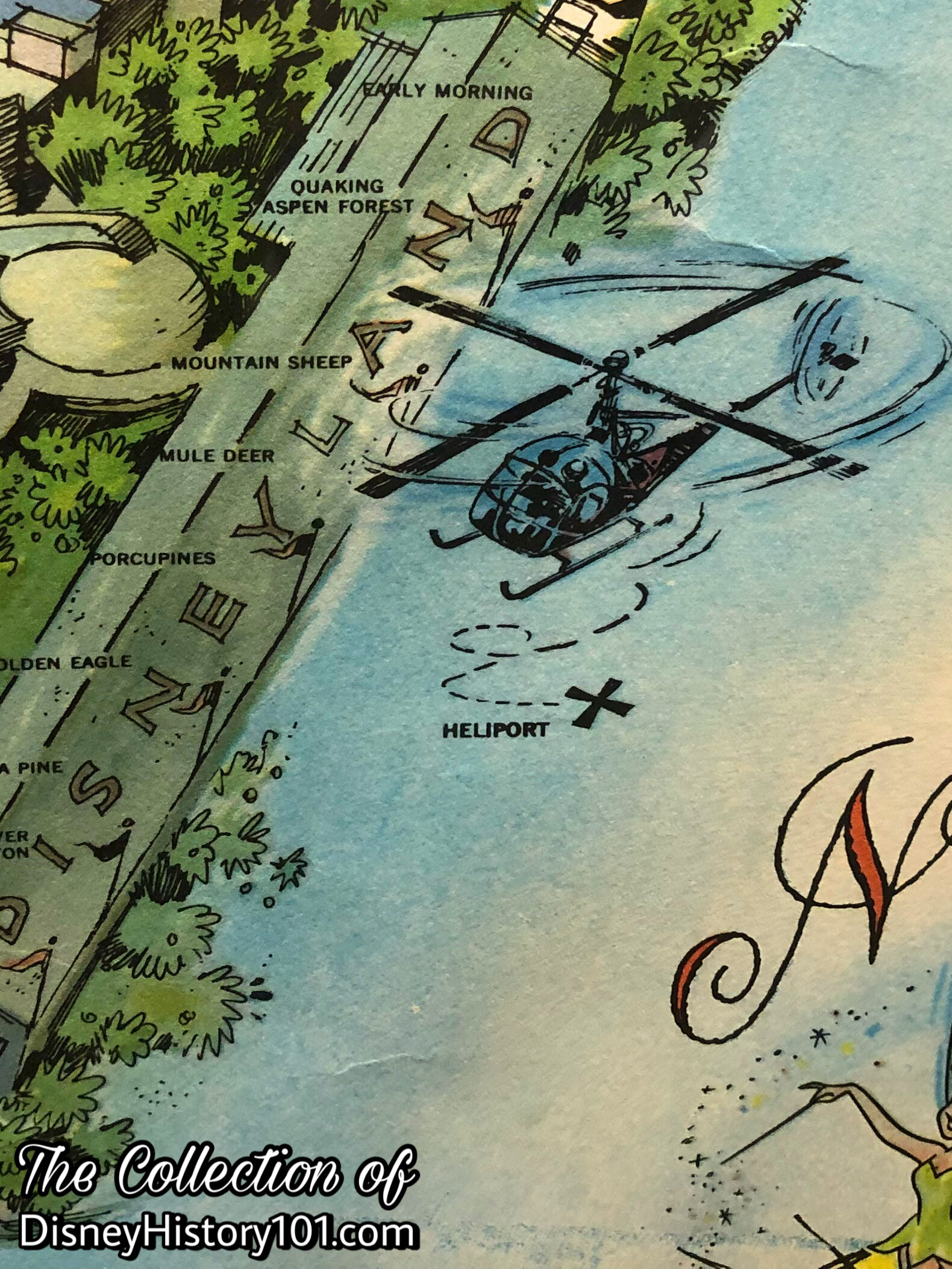
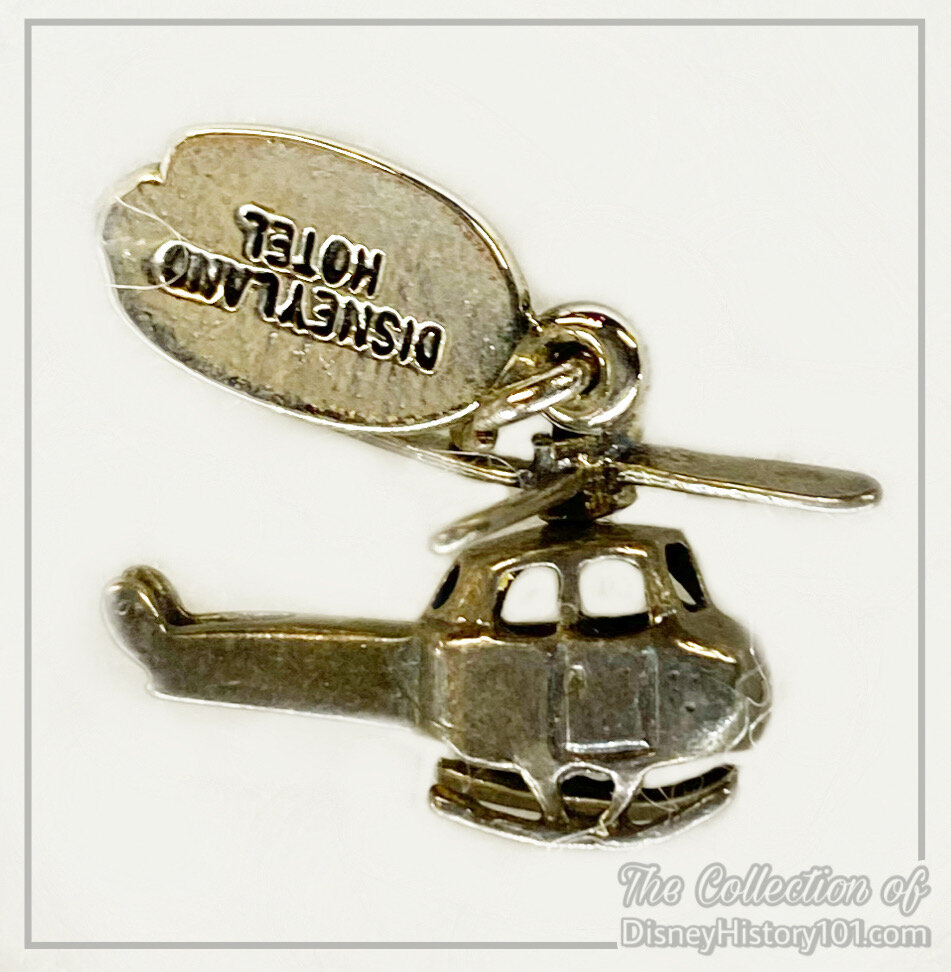
Souvenir Charms (intended for jewelry or other decorative purposes) commemorated many of Disneyland’s attractions, while some (like this Helicopter-shaped charm) commemorated the Disneyland Hotel.
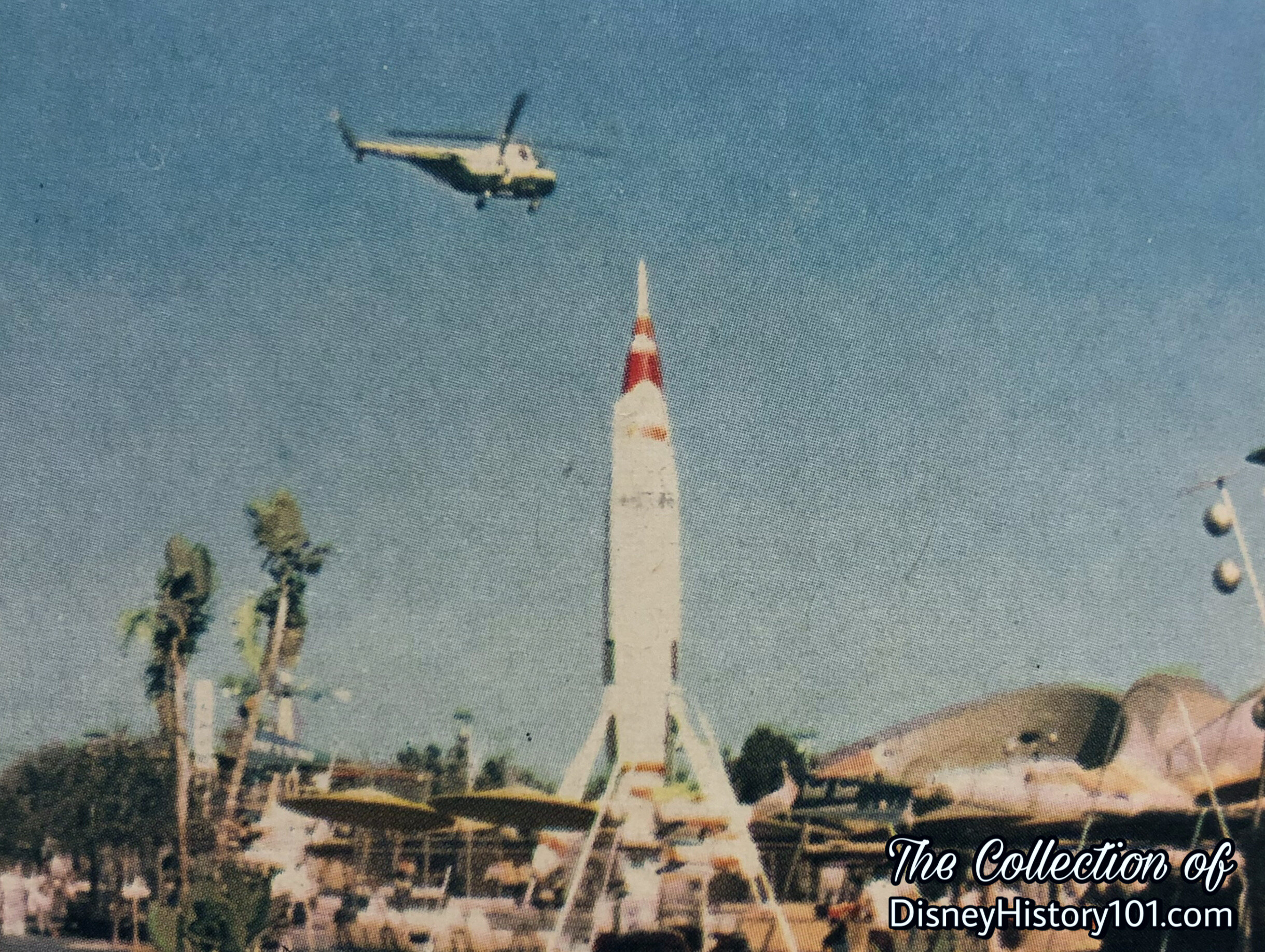
The helicopters were “Good Show” - supporting a positive Disney image! By 1956, promotional photos by Mel Kilpatrick captured Walt and Charlie Pearson greet incoming helicoptor guests. Disneyland Holiday Magazine was a favorite souvenir of Disneyland guests who loved “color pictures of Disneyland.” Among those (published Winter, 1957-1958) was this image of one of Los Angeles Airways’ Sikorsky S-55’s flying near Tomorrowland, granting guests a view “of things to come in the world of 1987.” It seems that the helicopters were a Disneyland and Tomorrowland attraction - part of the theme park experience.
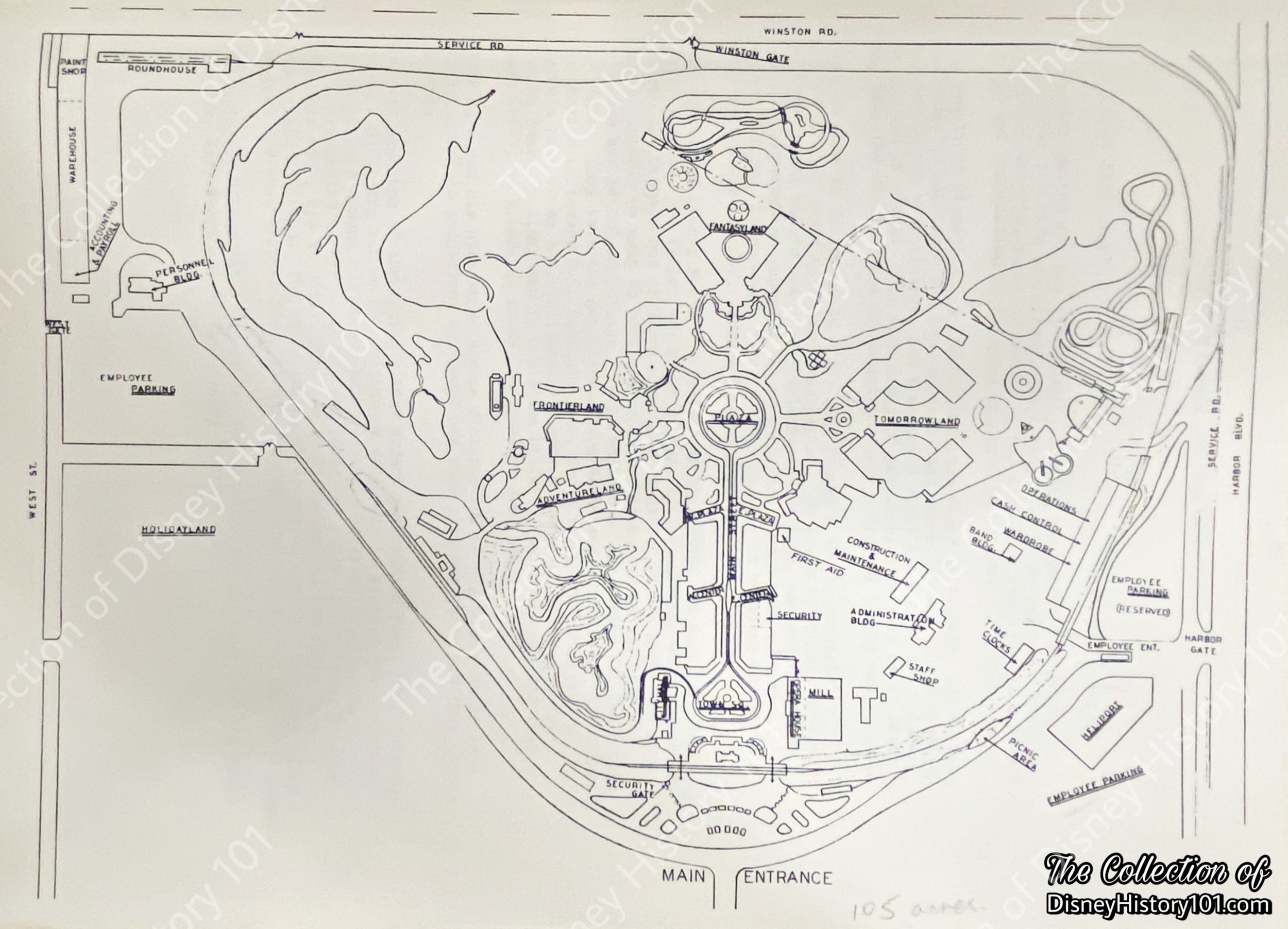
By October of 1959, the company was (1) of over sixty-eight other firms playing a vital part in the team effort to bring happiness to Disneyland’s Guests. Some were small, specialized individual operators; some were huge companies such as Swift & Co. - the Bank of America - United Paramount Theaters (which you hear as UPT) - Carnation - Richfield - General Dynamics - Crane - and many others. These companies used the park to publicize their wares, leased space in the Park to sell their wares, and Disneyland collected advertising fees from them.
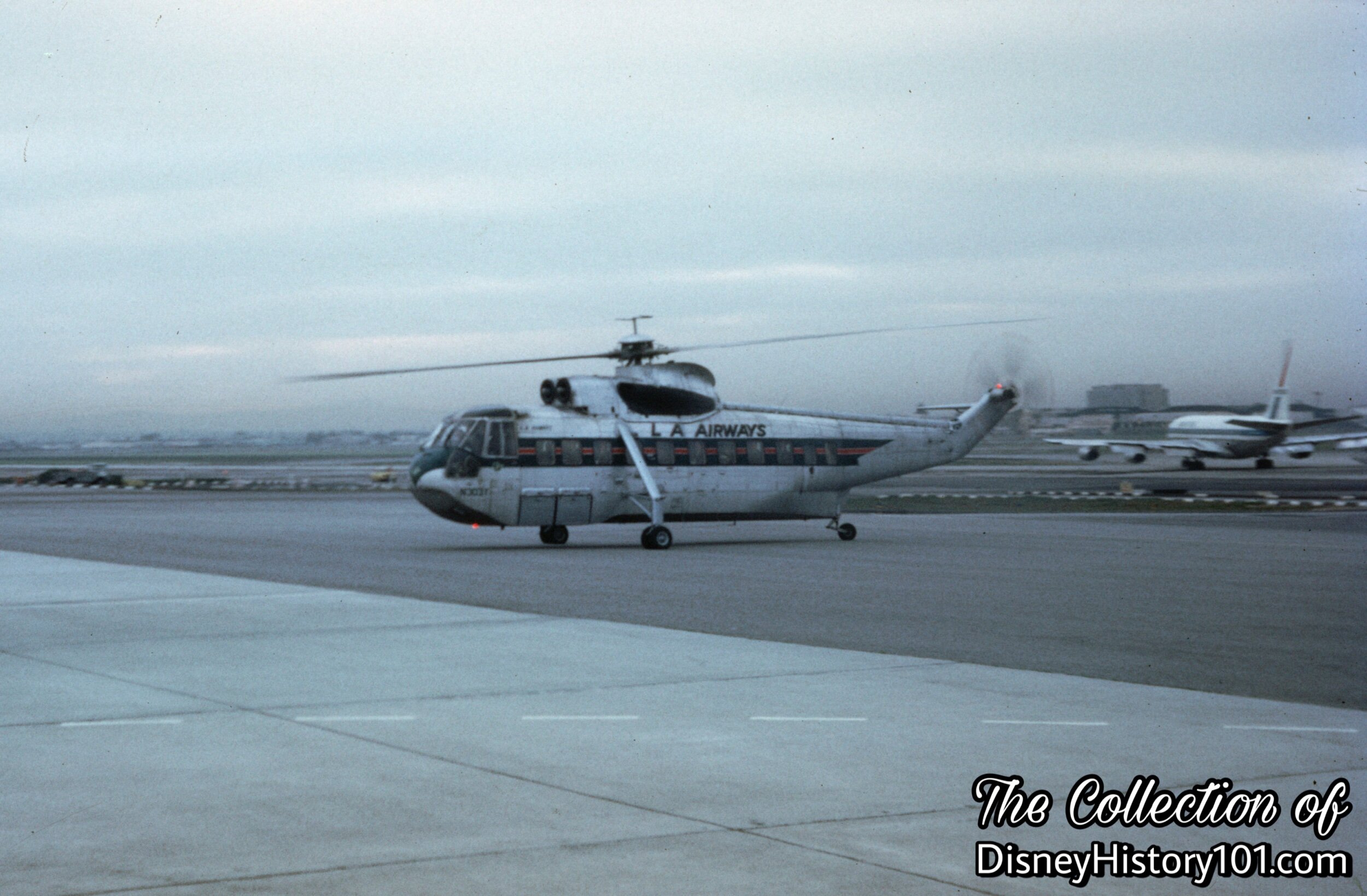
“The Sikorsky 61-L Copter Liner”
By 1960, those piston-powered S-55s were still in use by Los Angeles Airways. However, a new Sikorsky production prototype was tested on December 6, 1960 that would revolutionize travel. These new luxurious Sikorskys were designed from the start specifically for airline use and to airline standards - capable of carrying 3 crew members, 28 passengers, and 1000 pounds of cargo. Each one had a General Electric turbine-powered, twin-engine, advertised as “quiet, comfortable, safe!” In April, 1961. the 200-hour tie-down test was completed within 20 days. A provisional Type Certificate was awarded on May 22, 19st, and on June 21 the Type Inspection Authorization was received, with the Final F.A.A. Certificate to follow.
Los Angeles Airways president C.M. Belinn was optimistic about these new helicopters, and expected a growth of “one thousand per cent the first full year of operation and 2000% by the end of the second year.” Five brand new Sikorsky 61-L turbocopters boasting “twin-turbine reliability…all weather flight capability” were expected to be in use by Los Angeles Airways during late 1961. Starting in November of 1961, the first of four S-61L Sikorskys were delivered to the airline. The following year in March of 1962, the airway began operating the S-61Ls.
By 1961, Los Angeles Airways’ passenger Sikorsky “Copter Liners” had carried more than 2,000,000 passengers over 60,000,000 miles, in a “convenient, relaxed way…over freeway jams.” By this time, Los Angeles Airways was making 60 flights per day from Los Angeles International Airport to Disneyland (at $15 for one round-trip fare), Anaheim - and total one-way time, was an astounding 15 minutes (though some historians claim that there were“22 flights a day” to and from Disneyland! That very same year (of 1961), Disneyland’s decision makers were also so confident in Los Angeles Airways’ Sikorsky fleet, that the Disneyland Hotel was given its own Heliport, which accommodated 2 helicopters at one time. The third copter-liner arrived by May of 1962, and by the end of the month, the three had flown a total of 1,597 hours of airtime. The fourth (and final) helicopter was delivered to the company on July 10, 1962.
The helicopters over Disneyland were so popular that when (in 1960) the Los Angeles Sound Effects Company produced a record of sounds (of popular Southern California attractions, intended for use by filmmakers), the Los Angeles Airways Sikorskys were among the tracks included. You may have heard these very sounds over radio or television broadcasts from 1960 onward! A Sikorsky-style commercial helicopter was even featured on this (c.1966) post-Tencennial Disneyland map (below)!
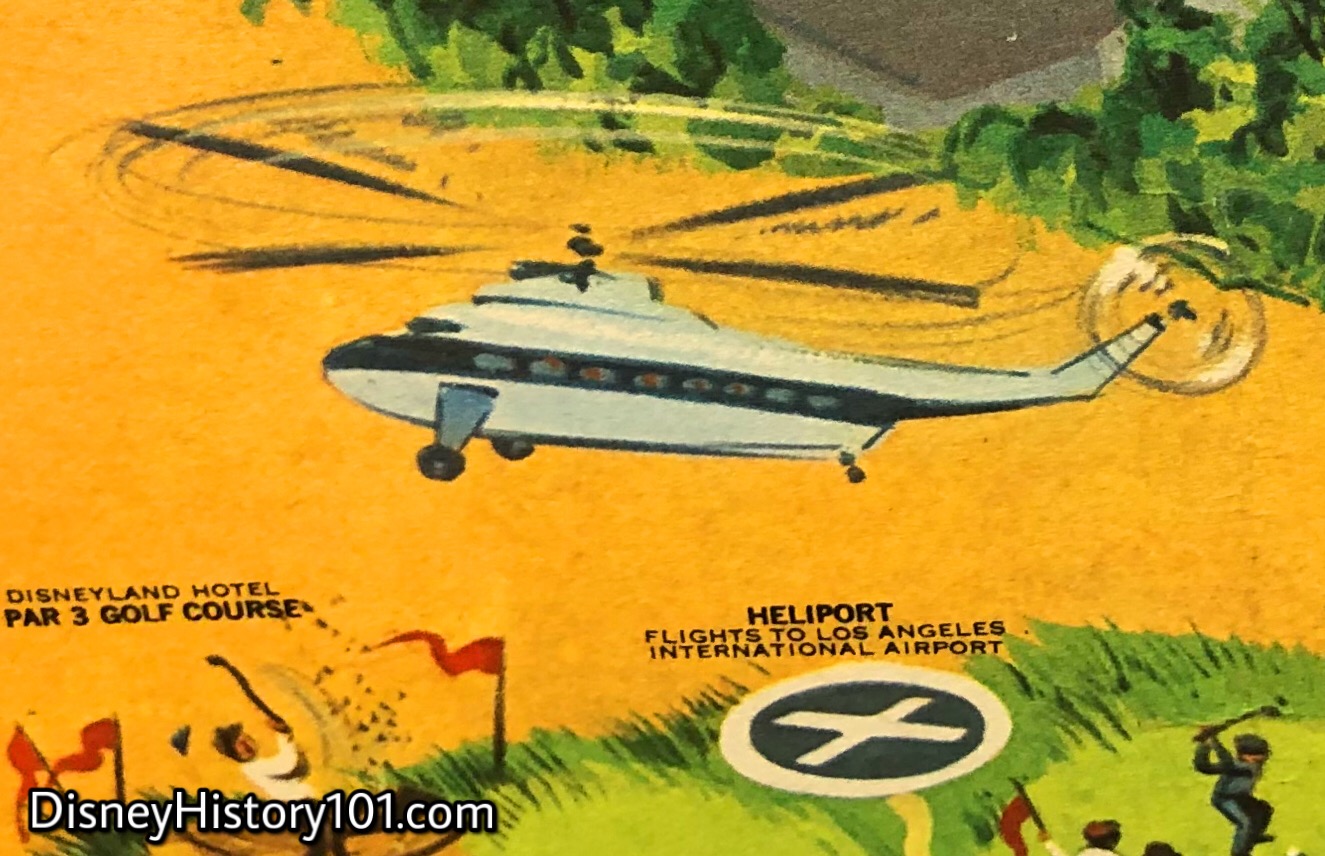
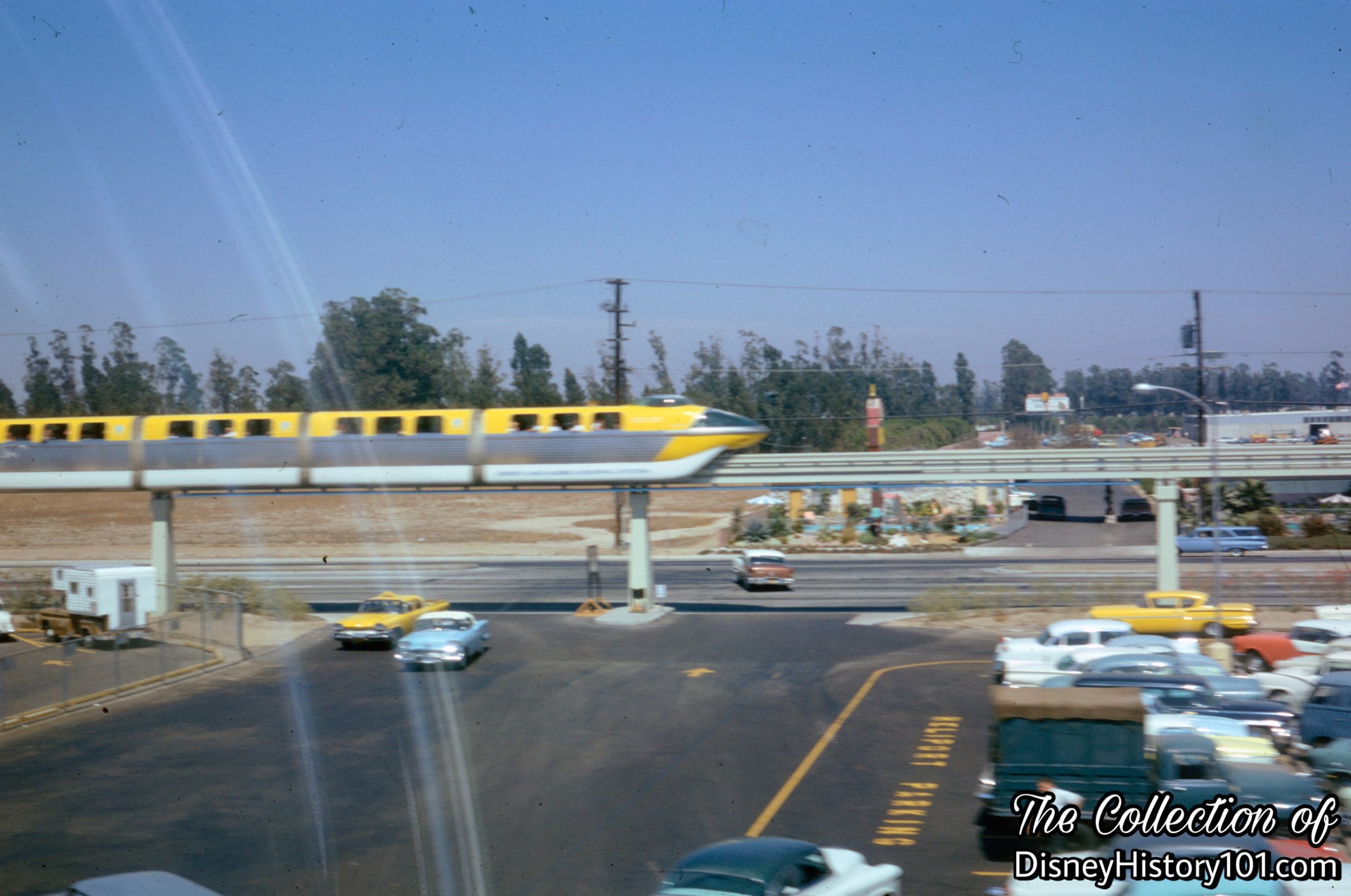
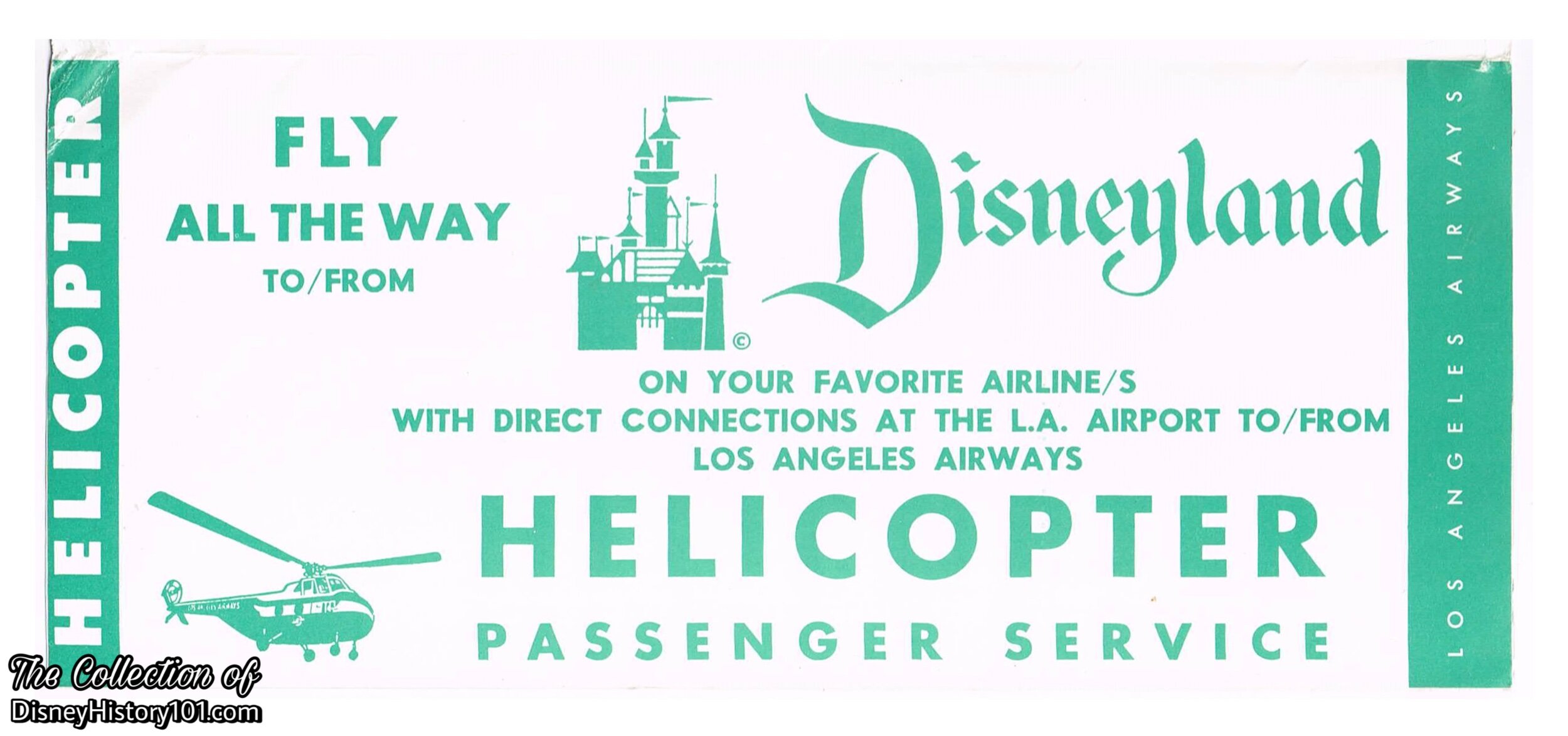
Perhaps Los Angeles Airways’ most frequented destination is highlighted on the cover of the 1960 service schedule. A graphic of the piston-powered S-55 is depicted, though the Sikorsky 61-L turbocopters were due to be in use by the time this schedule was printed and distributed.
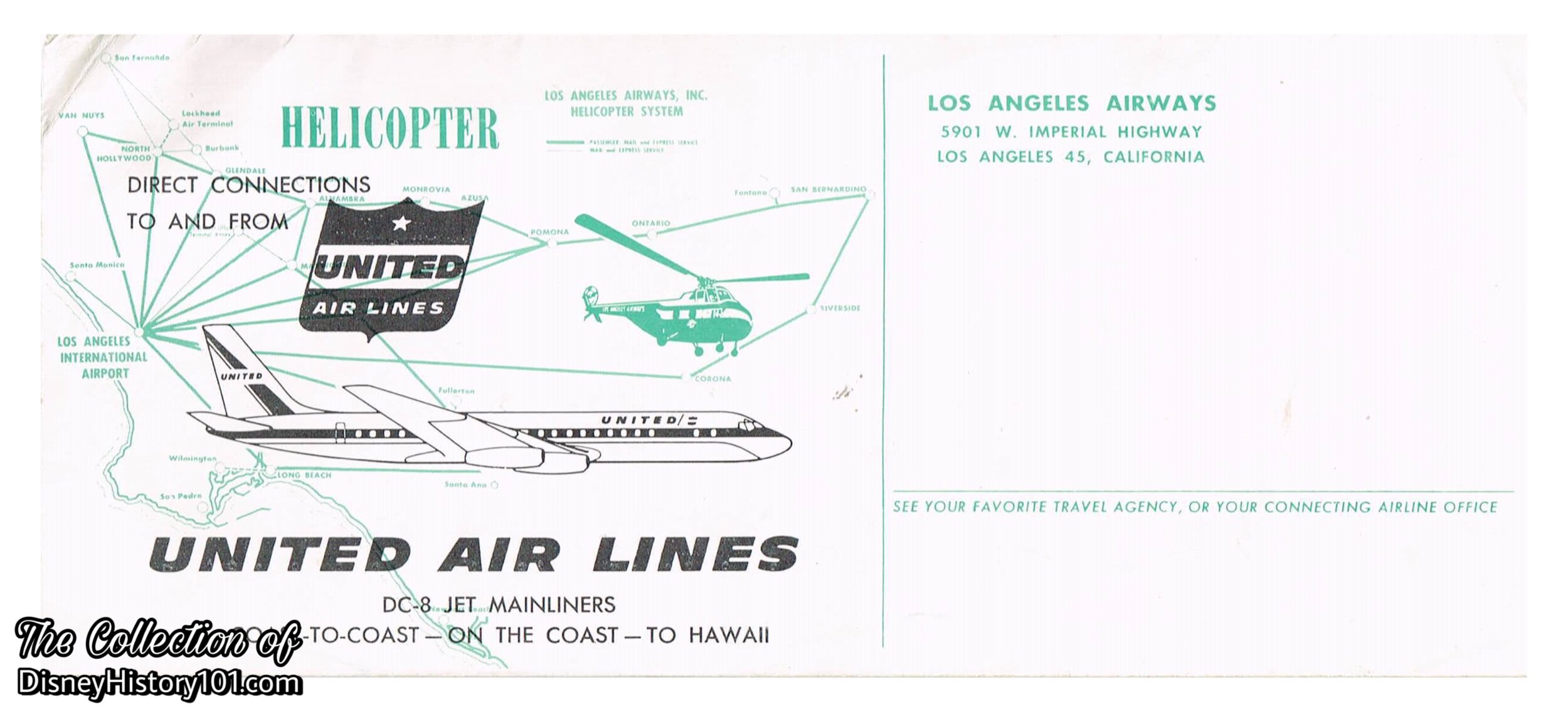
International travelers could avail themselves of United Airlines, to reach the Southern California area. Once visitors arrived, Los Angeles Airways’ network of Heliports offered quick and comfortable transportation to many destinations including “the happiest place on earth”.
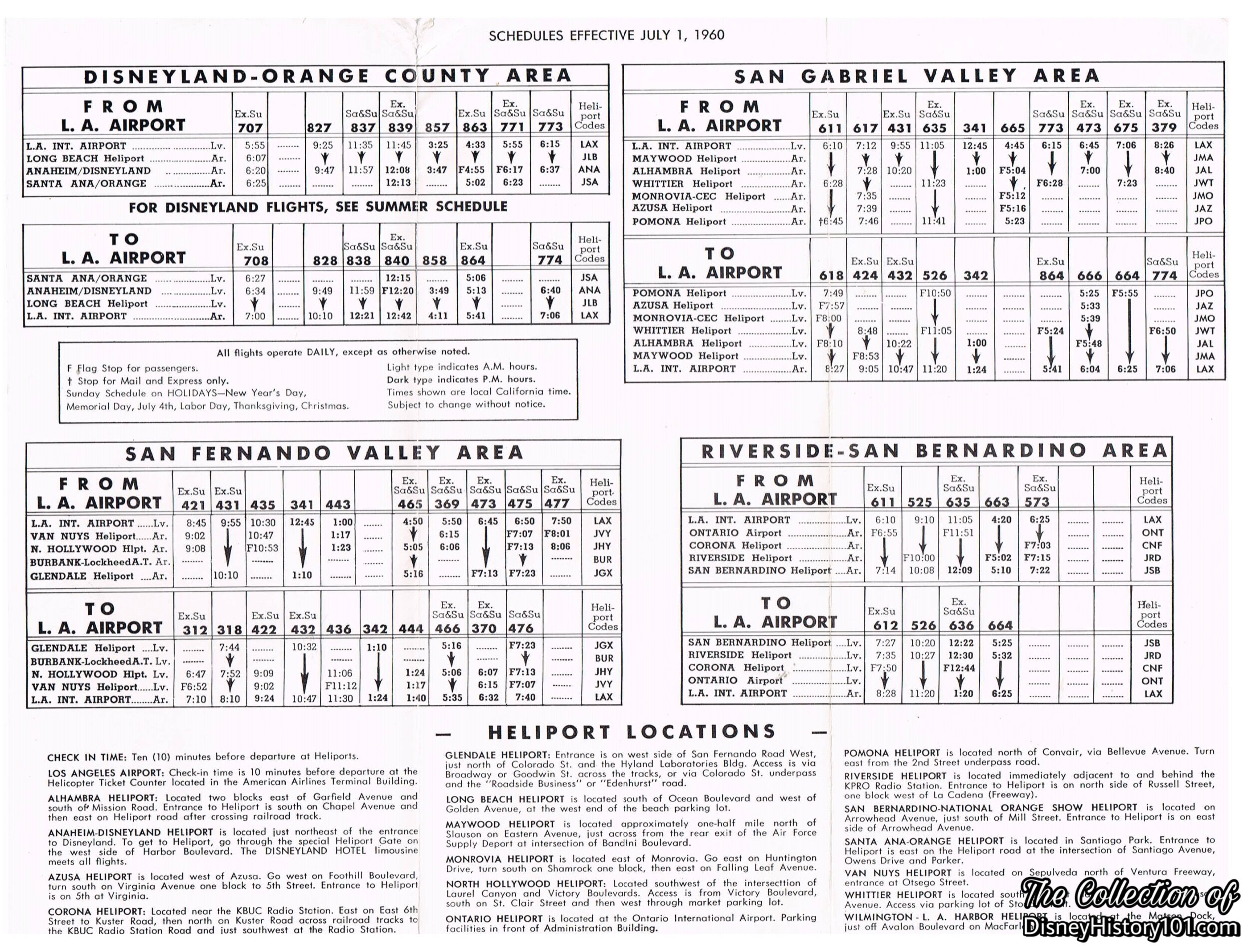
Service was offered to more Southern California residents and their guests, when helicopters began to make regular journeys to and from Los Angeles and Heliports in other Southern California counties (i.e. San Fernando Valley, San Gabriel, San Bernardino, and Orange County).
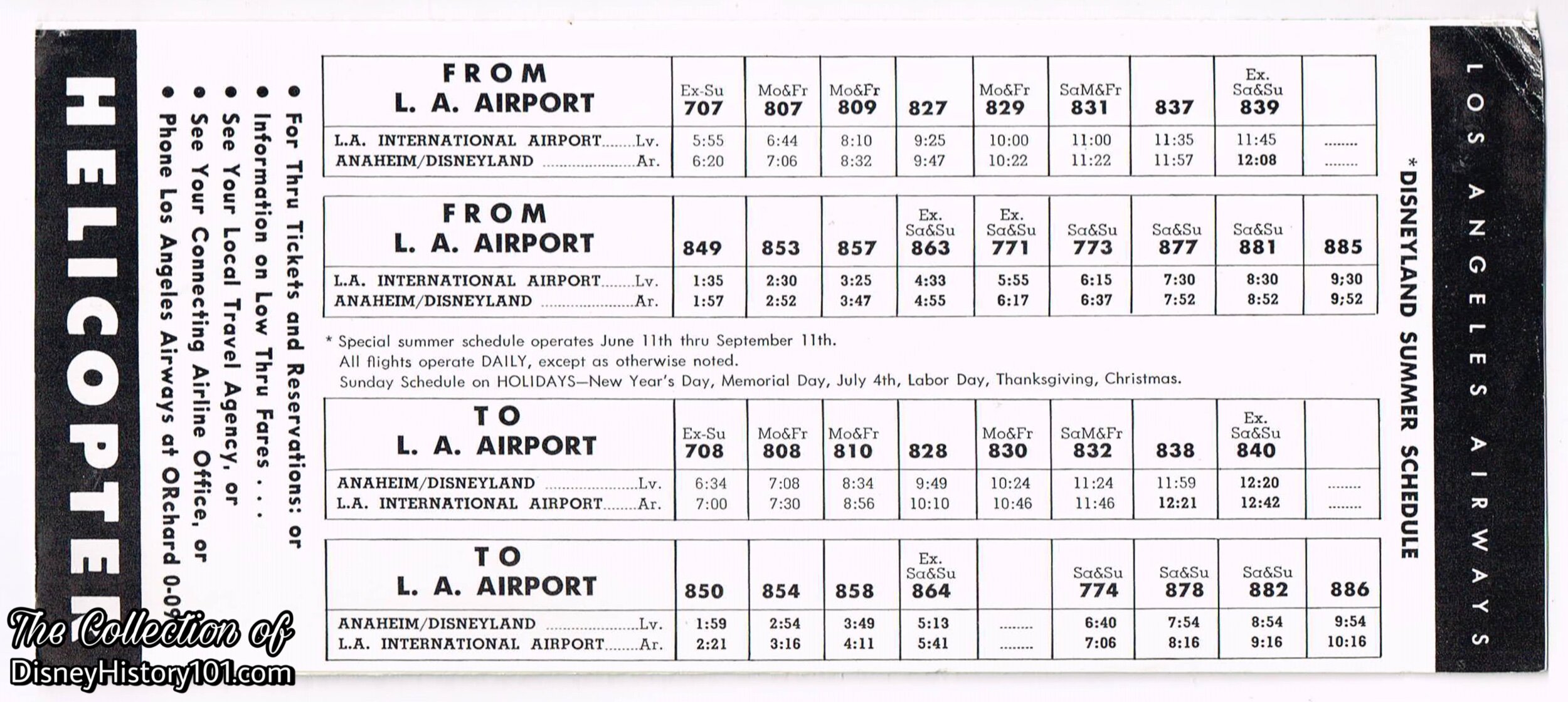
An entire page of the operation schedule is dedicated to flights both to and from Los Angeles Airport and Disneyland.
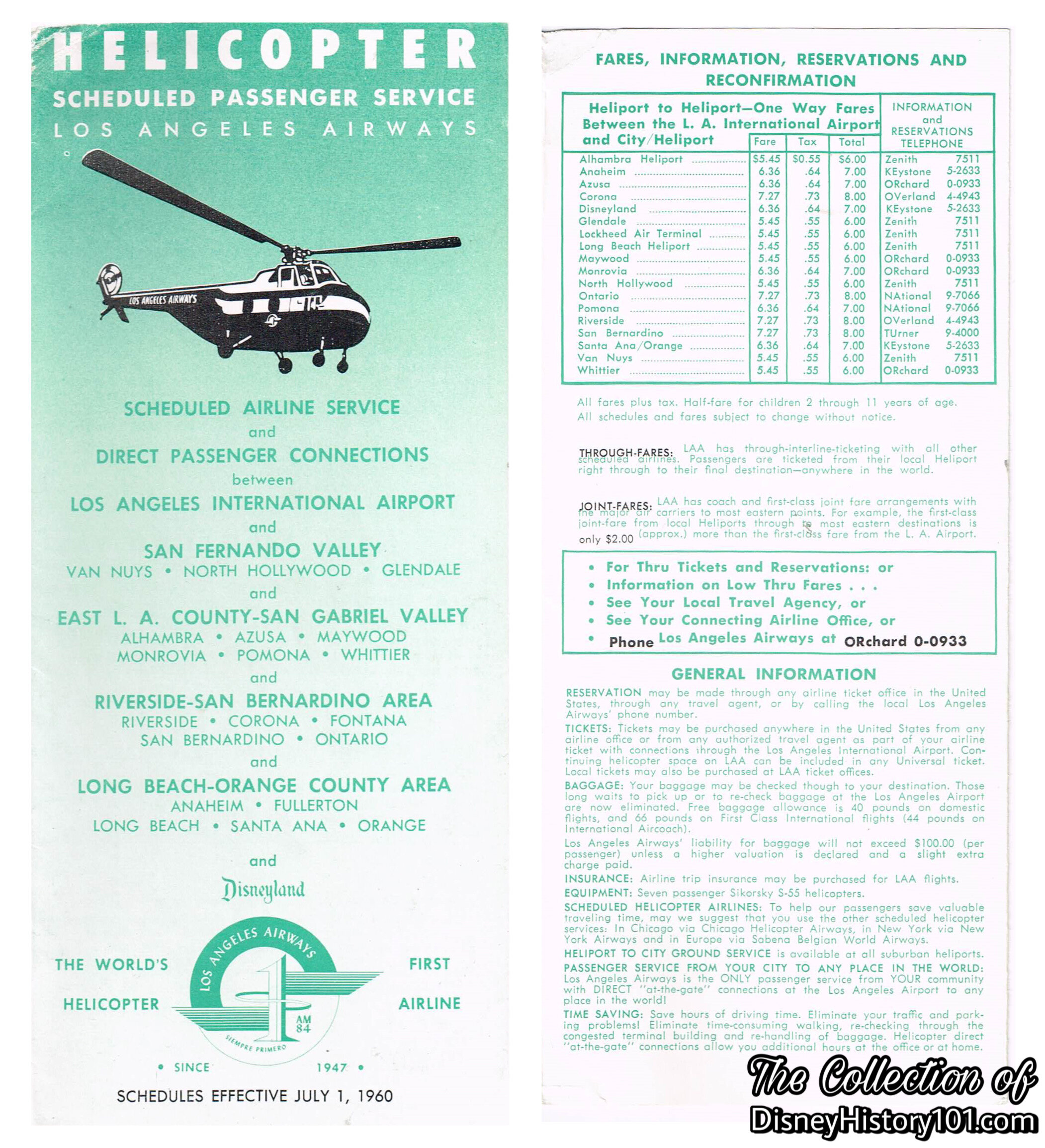
Other information about fares, baggage, insurance and other details give a better idea of the accommodations offered by Los Angeles Airways, to its passengers.
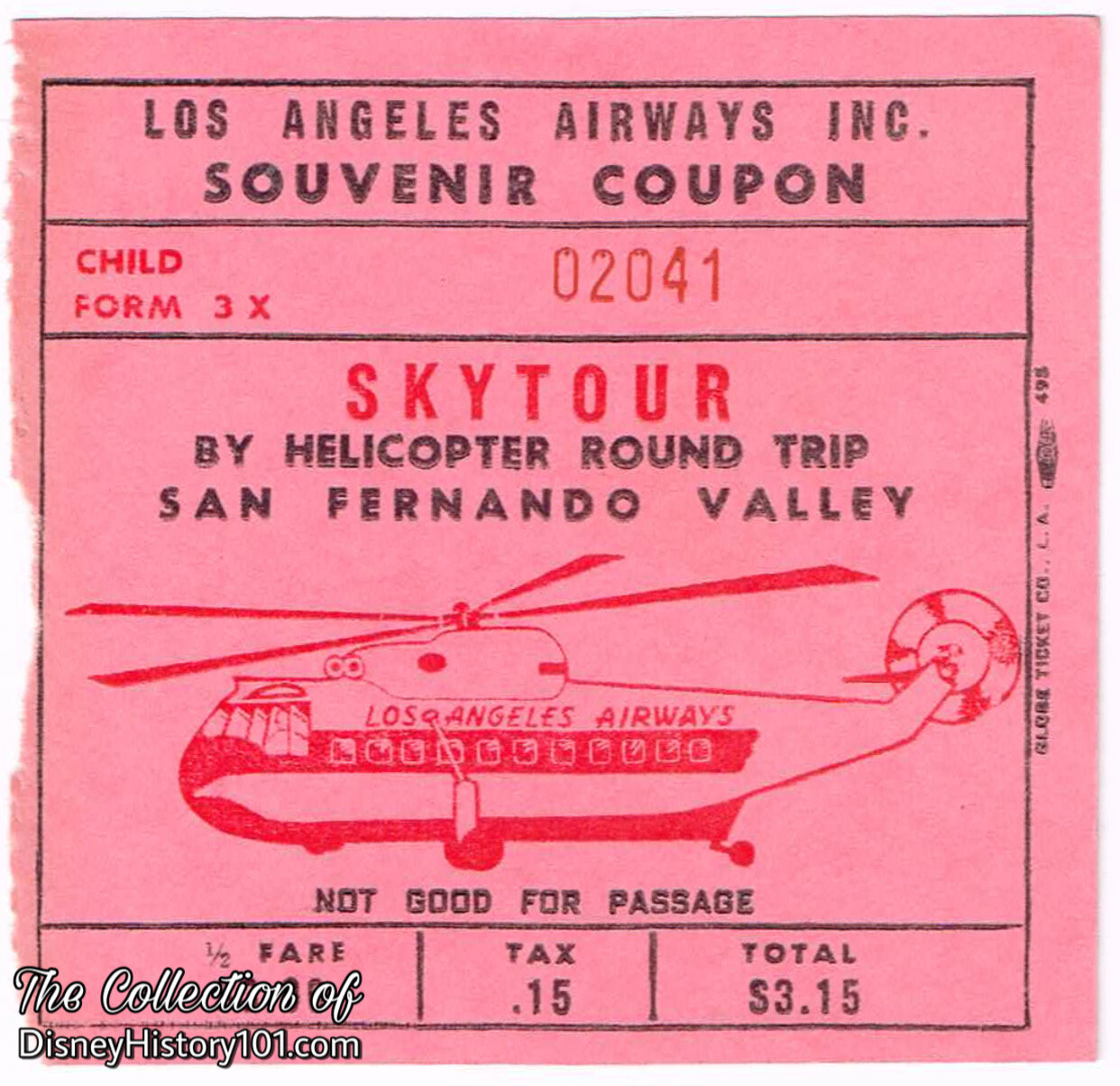
According to this children’s souvenir coupon, a 1/2 fare (1-way) was $3.15 (including tax).
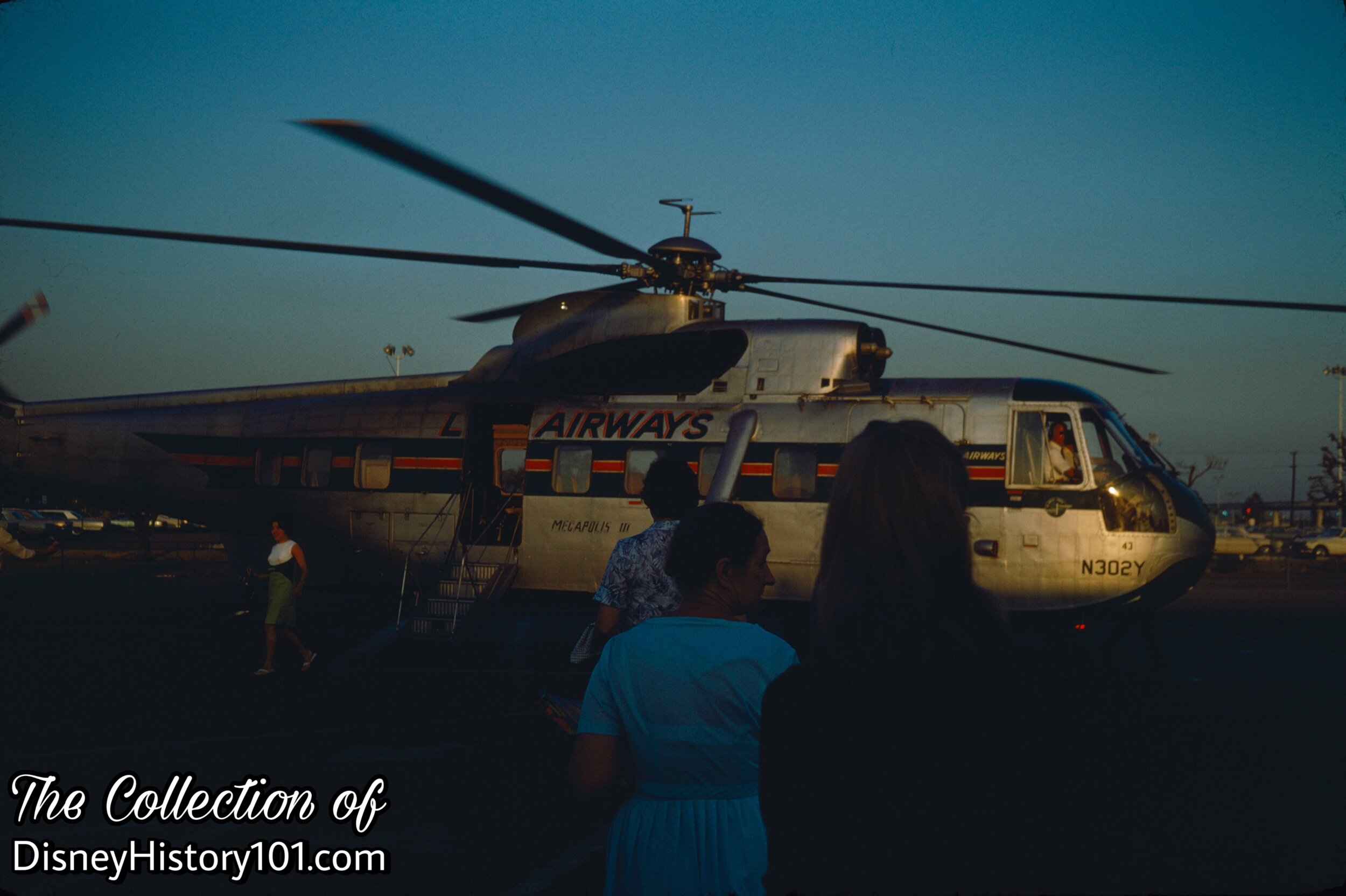
Late afternoon and early evening flights departed Disneyland Heliport. The Heliport was originally located where the Disneyland Employee Parking Lot (Section A) came to be located. Early daytime departures were also available from the Disneyland Heliport.
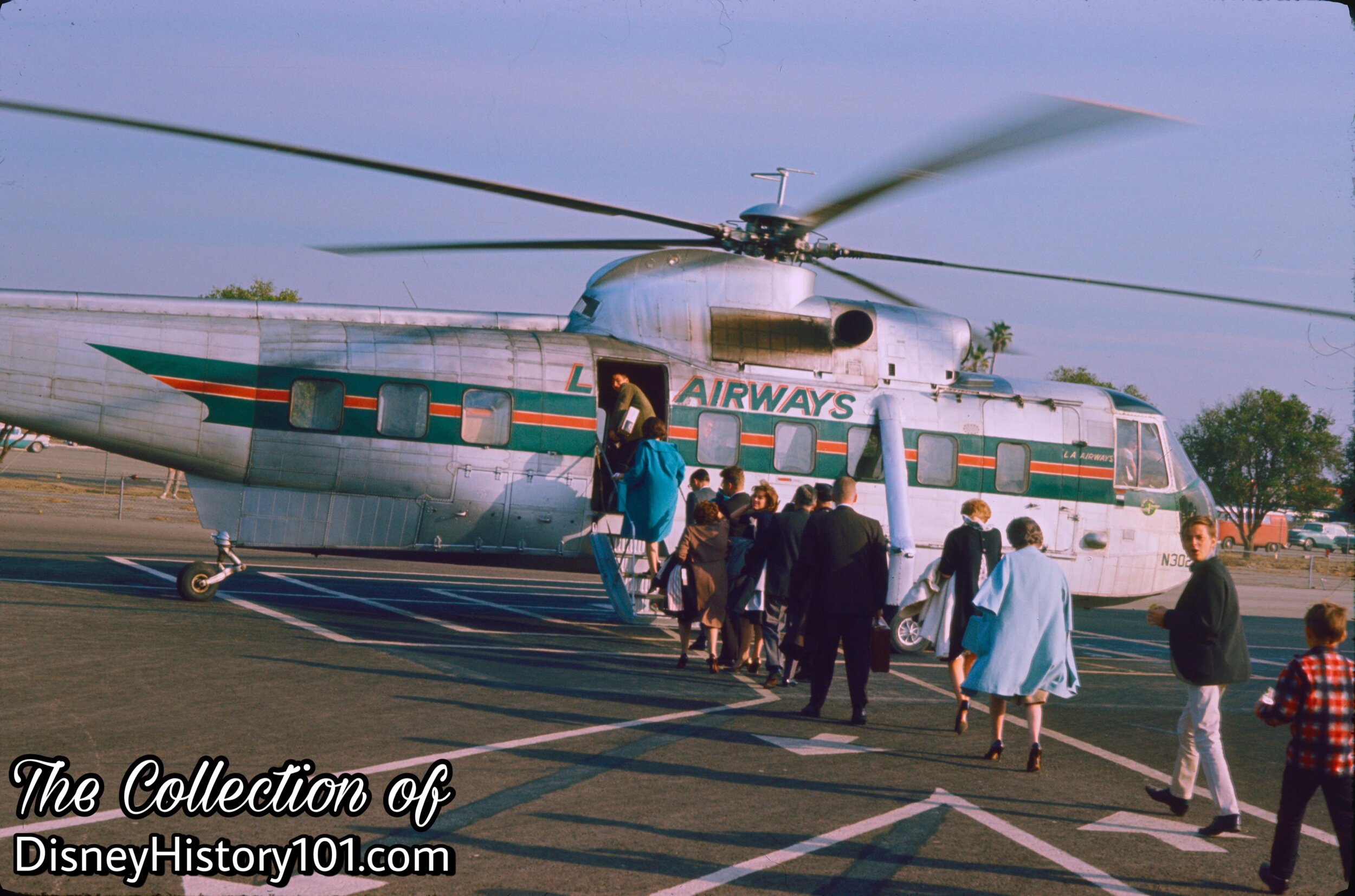
One of thirteen Sikorsky S-61L series helicopters built by Sikorsky between 1958 and 1980. This pictured Sikorsky (registration number N302Y) began service during March of 1962. Guided Tour Scripts of 1962 even drew attention to the new attraction :
“The helicopters you may see flying overhead today offer daily flight service to and from the Los Angeles International Airport. The helicopter landing pad is adjacent to the Disneyland Hotel just across West Street.”
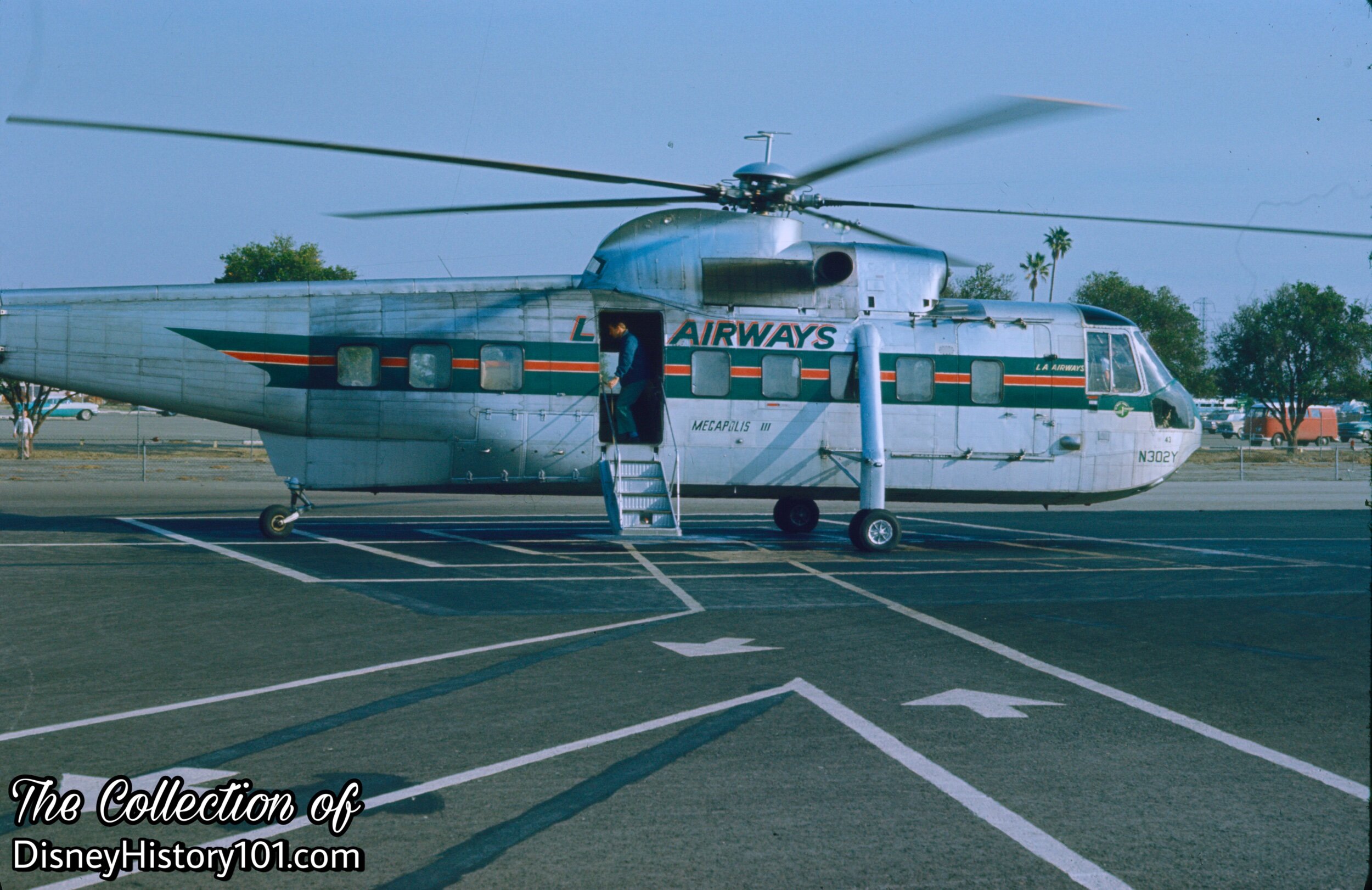
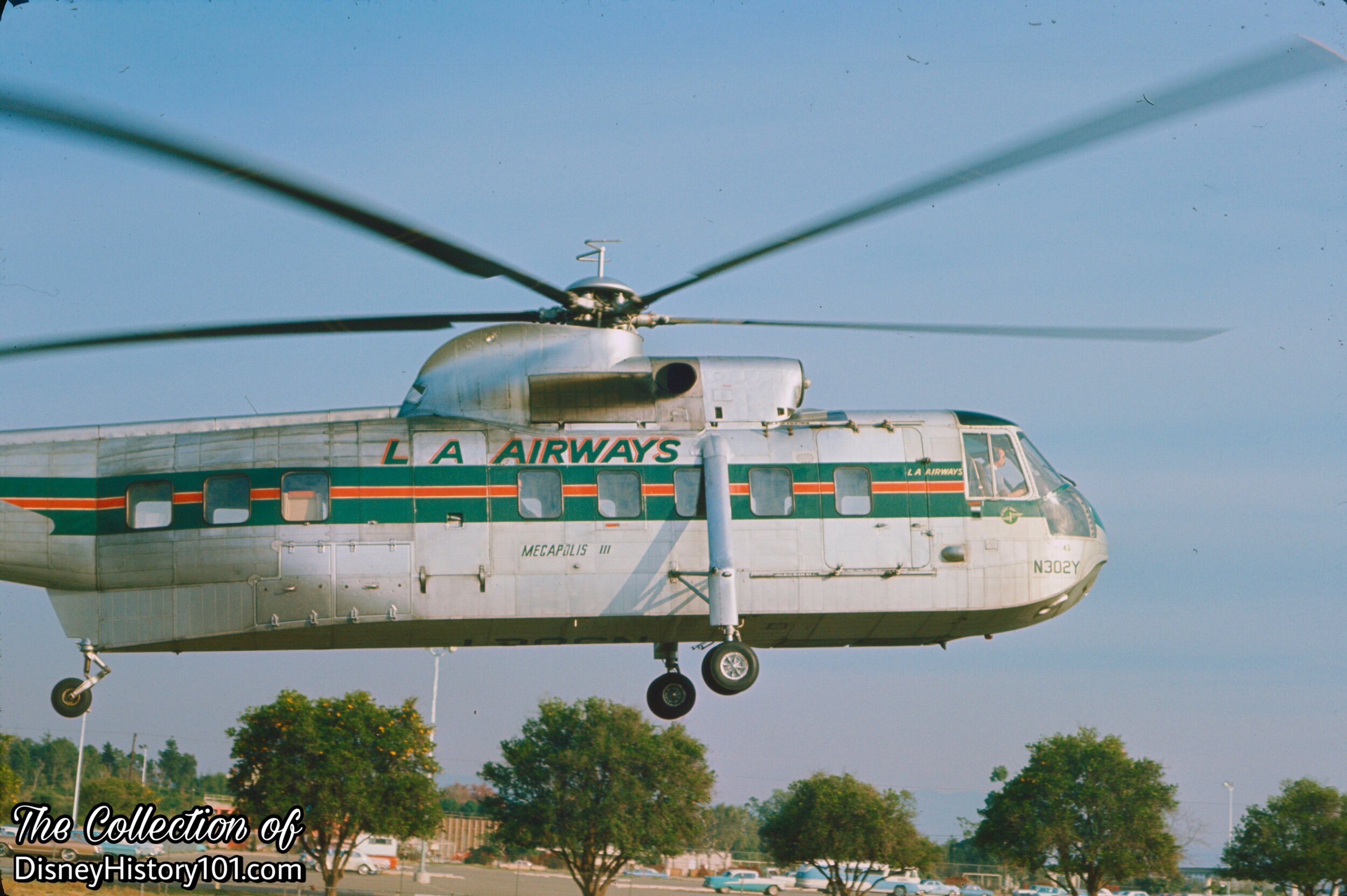
“Come on, everybody, here we go!”
Los Angeles Airways Sikorsky S-61L rises above the Disneyland Heliport and surrounding orange trees. “55er” John Hernandez spent most of his time at Disneyland with Virl Casey looking after the acres of Disneyland's oranges, some of which were on the 15 acres where the Heliport was.
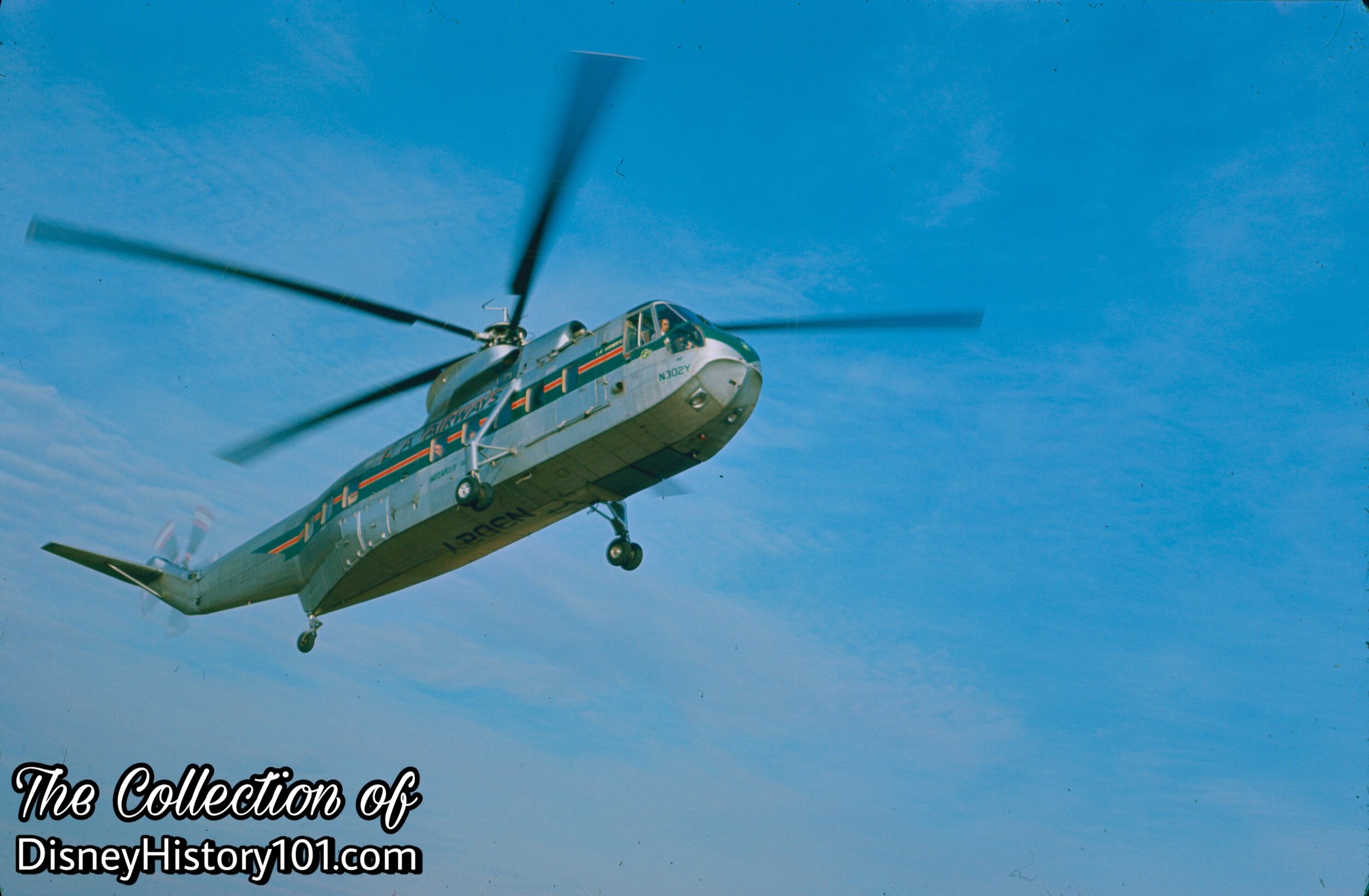
“You can fly! You can fly! You can fly!”
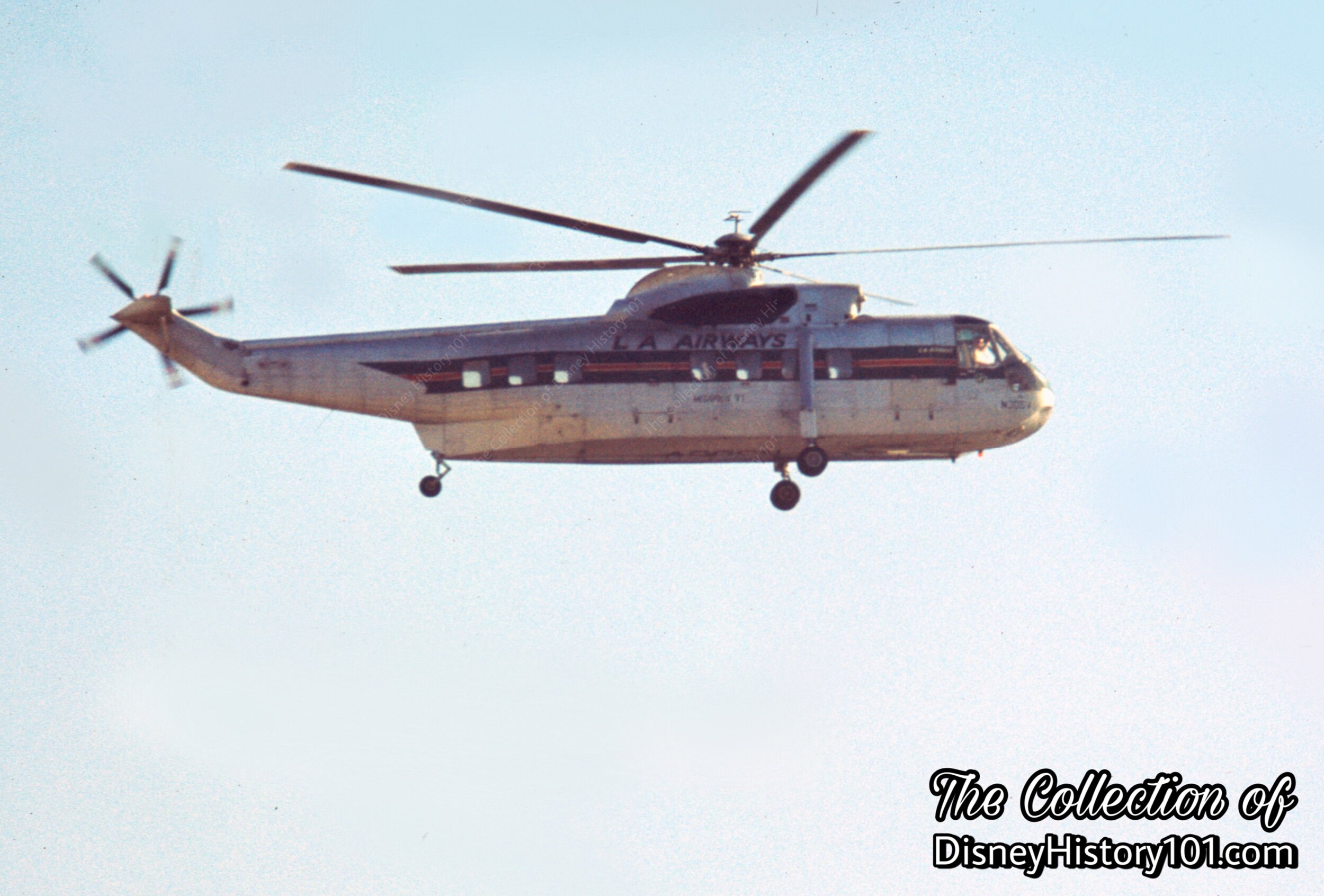
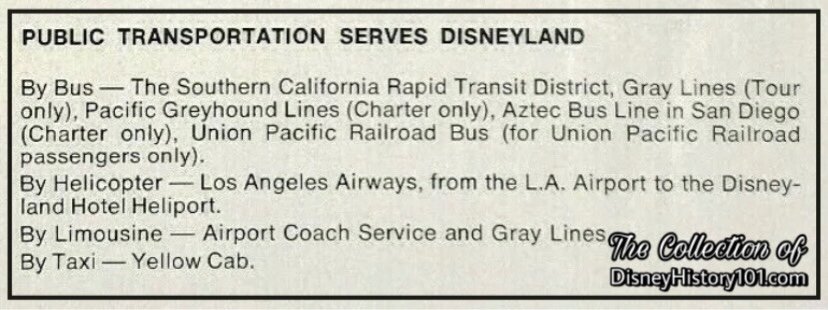
Seen here, is a typical Vacationland Public Transportation Information Section, mentioning Los Angeles Airways as an alternative form of transportation from L.A. Airport to Disneyland. Vacationland was a free publication, distributed to Southern California hotels and visitor centers. This sort of information was regularly included in the publication.
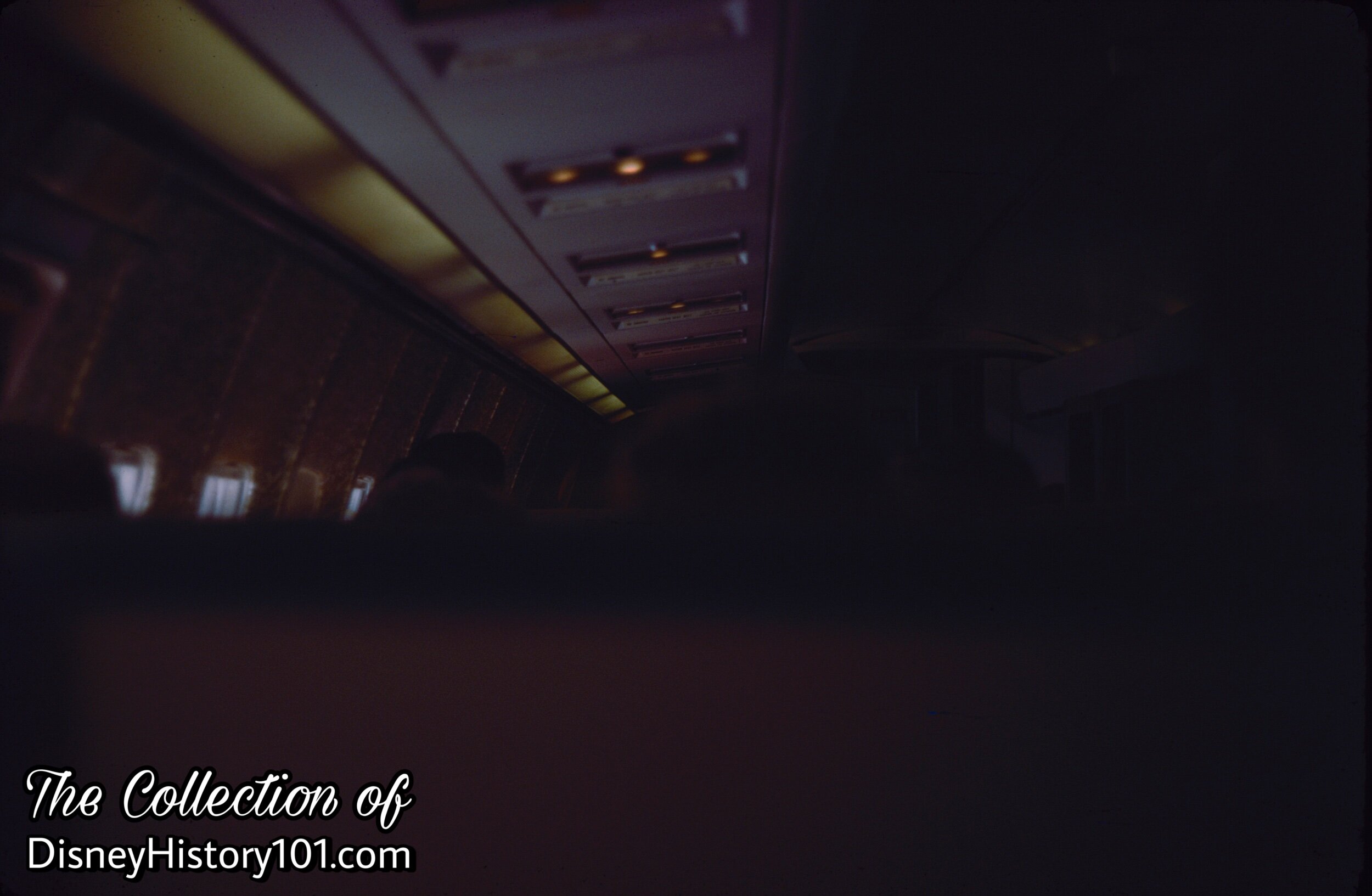
The interior of the the Sikorsky 61-L was more spacious than other helicopters used by commercial airline companies. The Sikorsky 61-L had seating to comfortably accommodate 26 to 28 passengers, a luggage compartment, a storeroom, and even a lavatory (or, toilet).
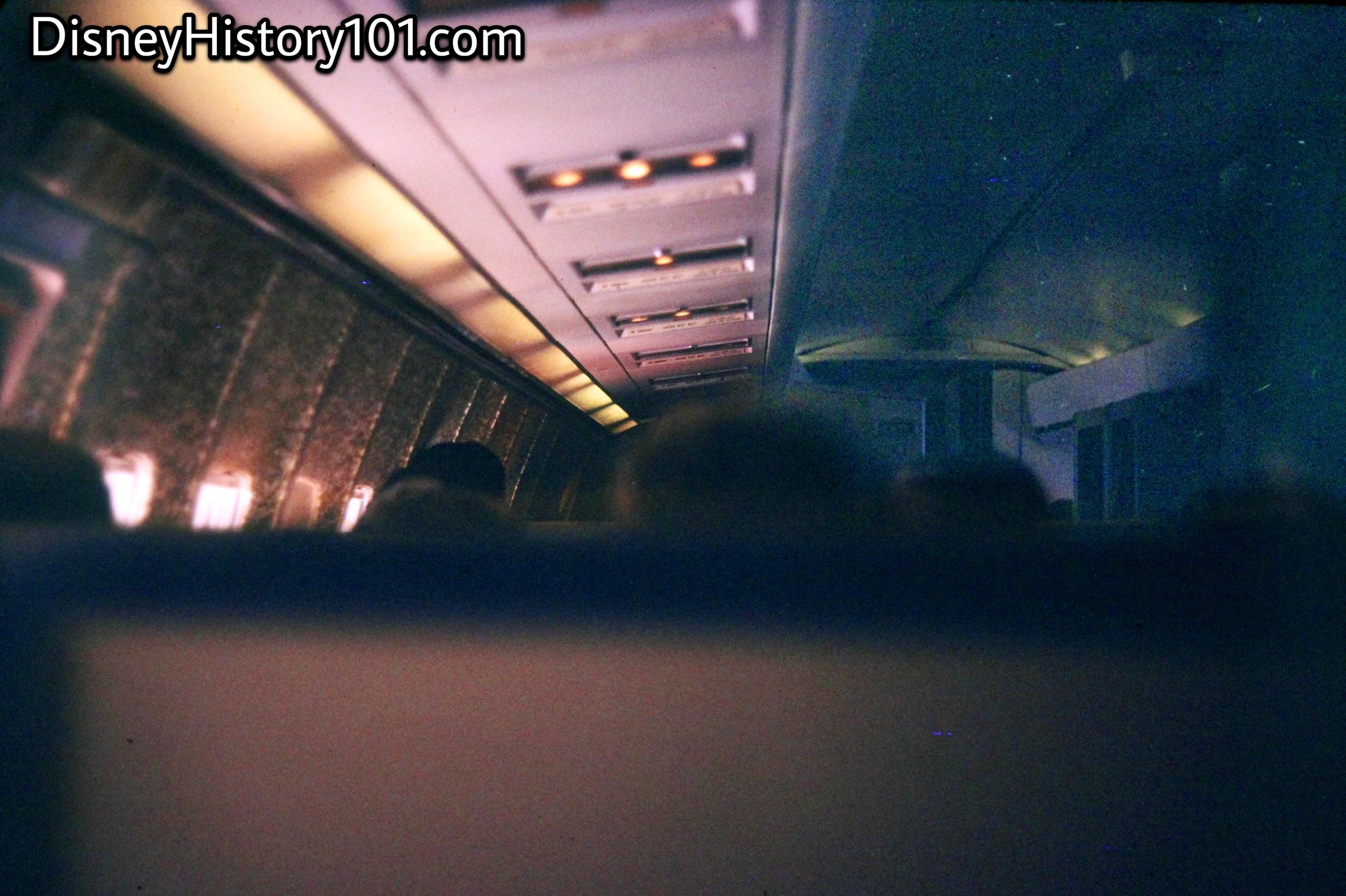
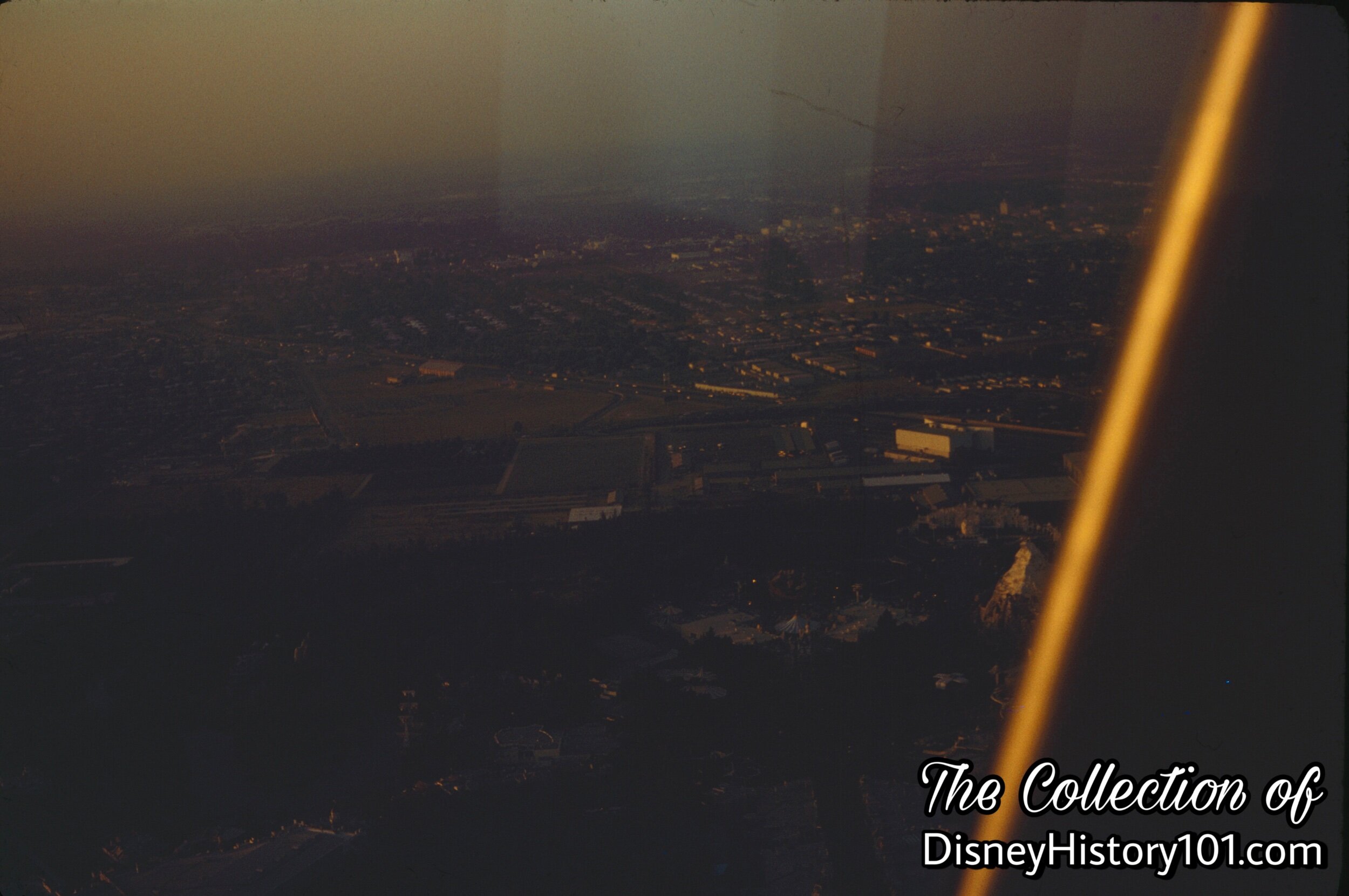
The Sikorsky would circle around Disneyland. In the foreground, you’ll spot the structures which line Main Street U.S.A., leading to Sleeping Beauty Castle!
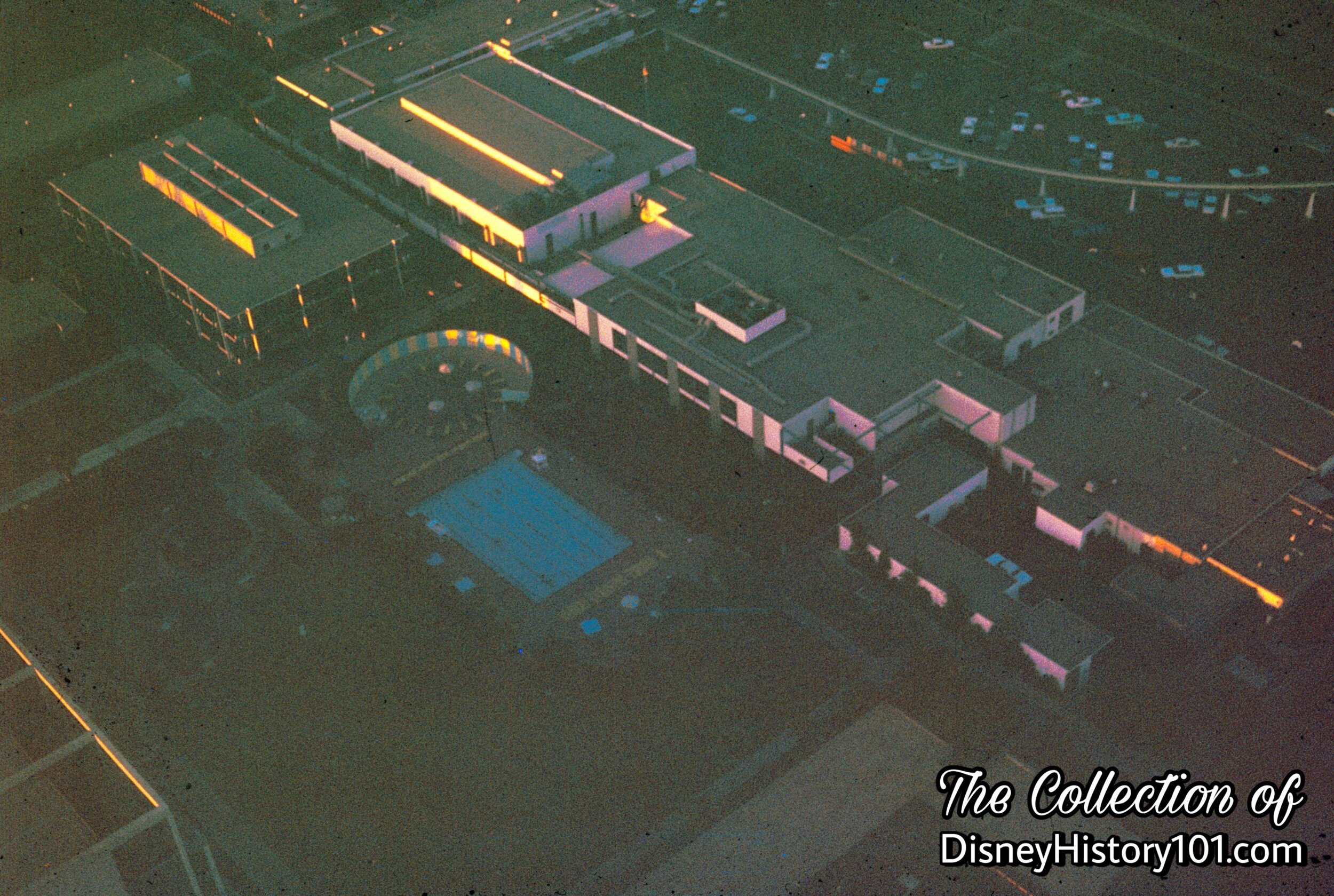
This was a typical view from a passenger window seat, as the Sikorsky rose above the Disneyland Hotel.
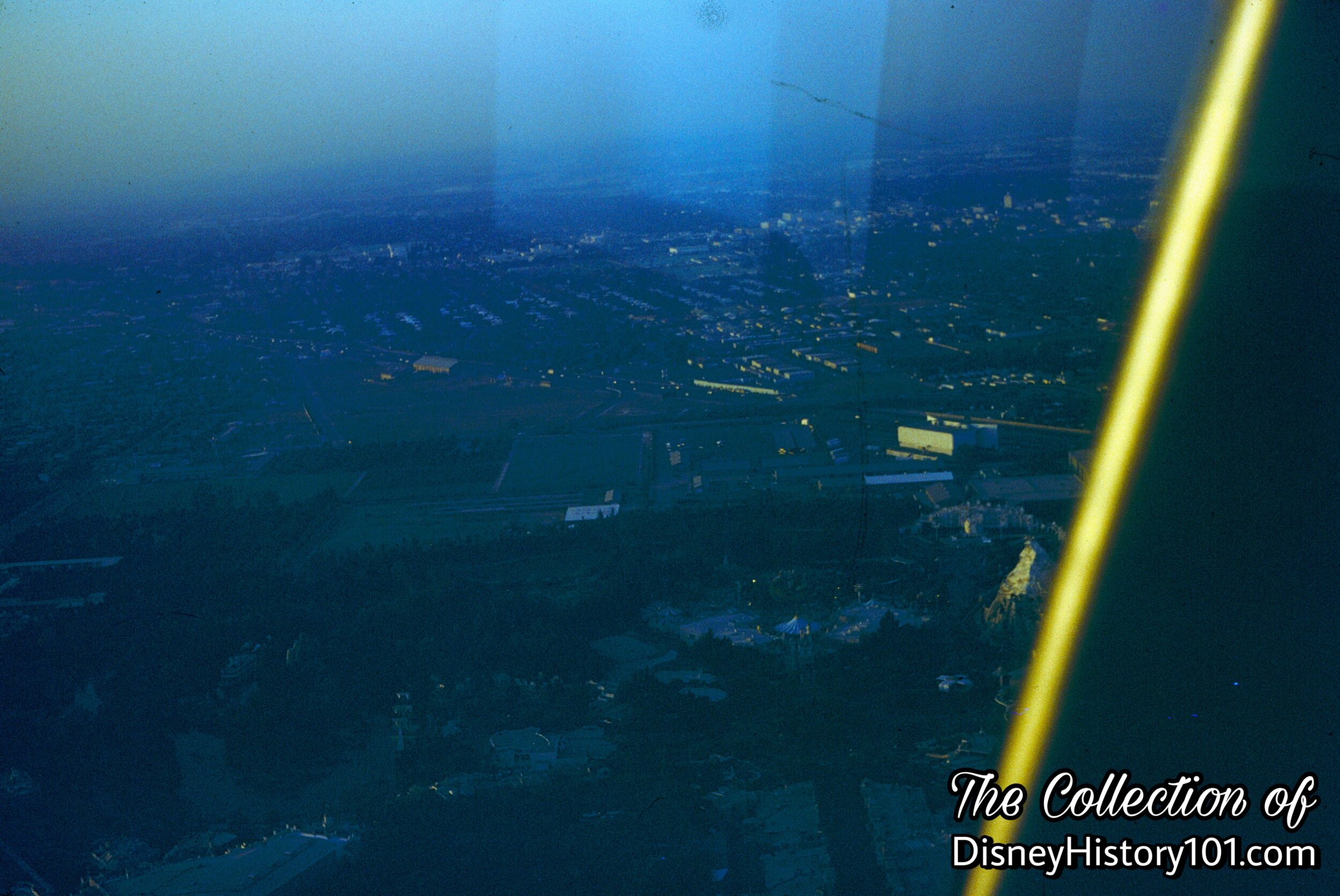
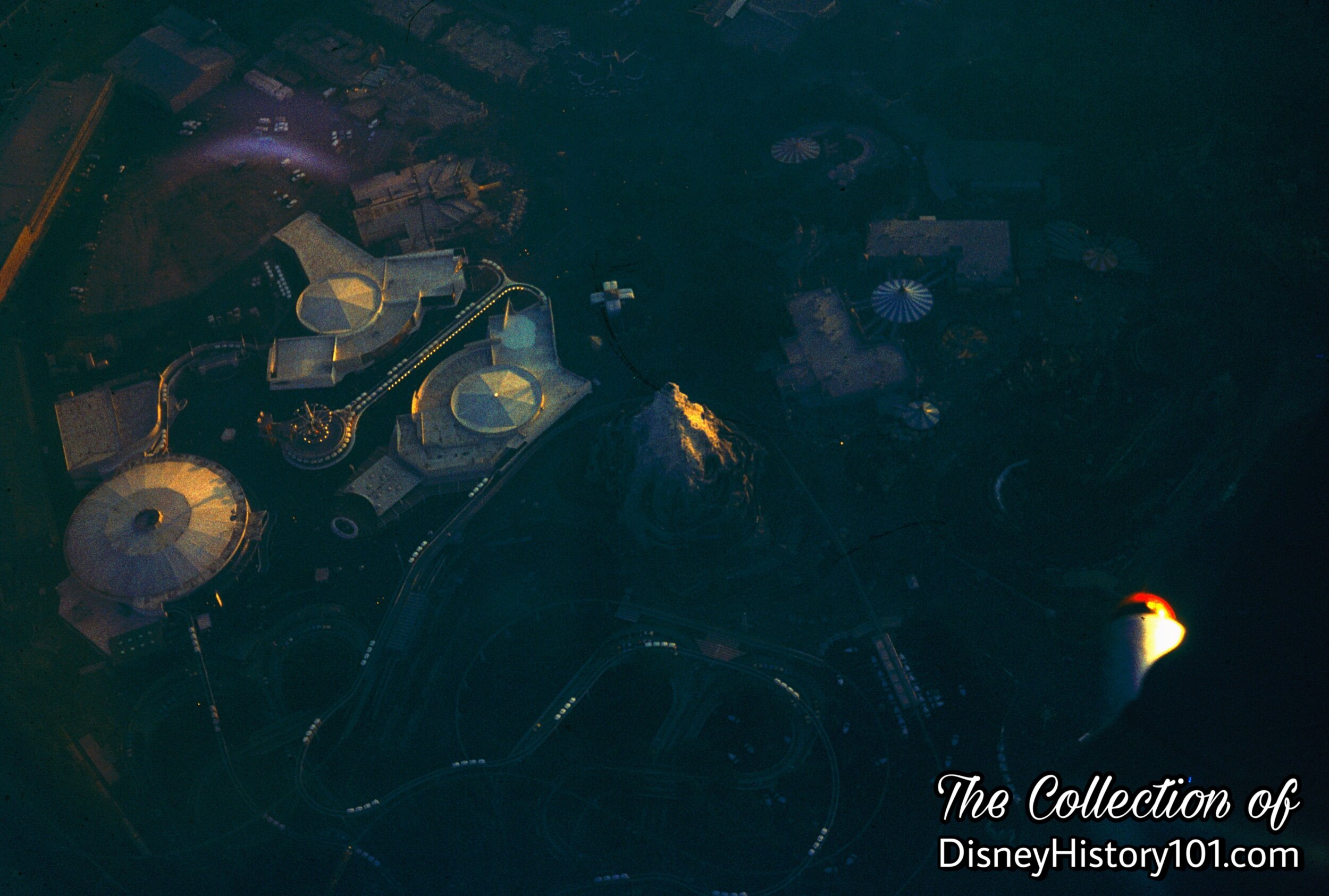
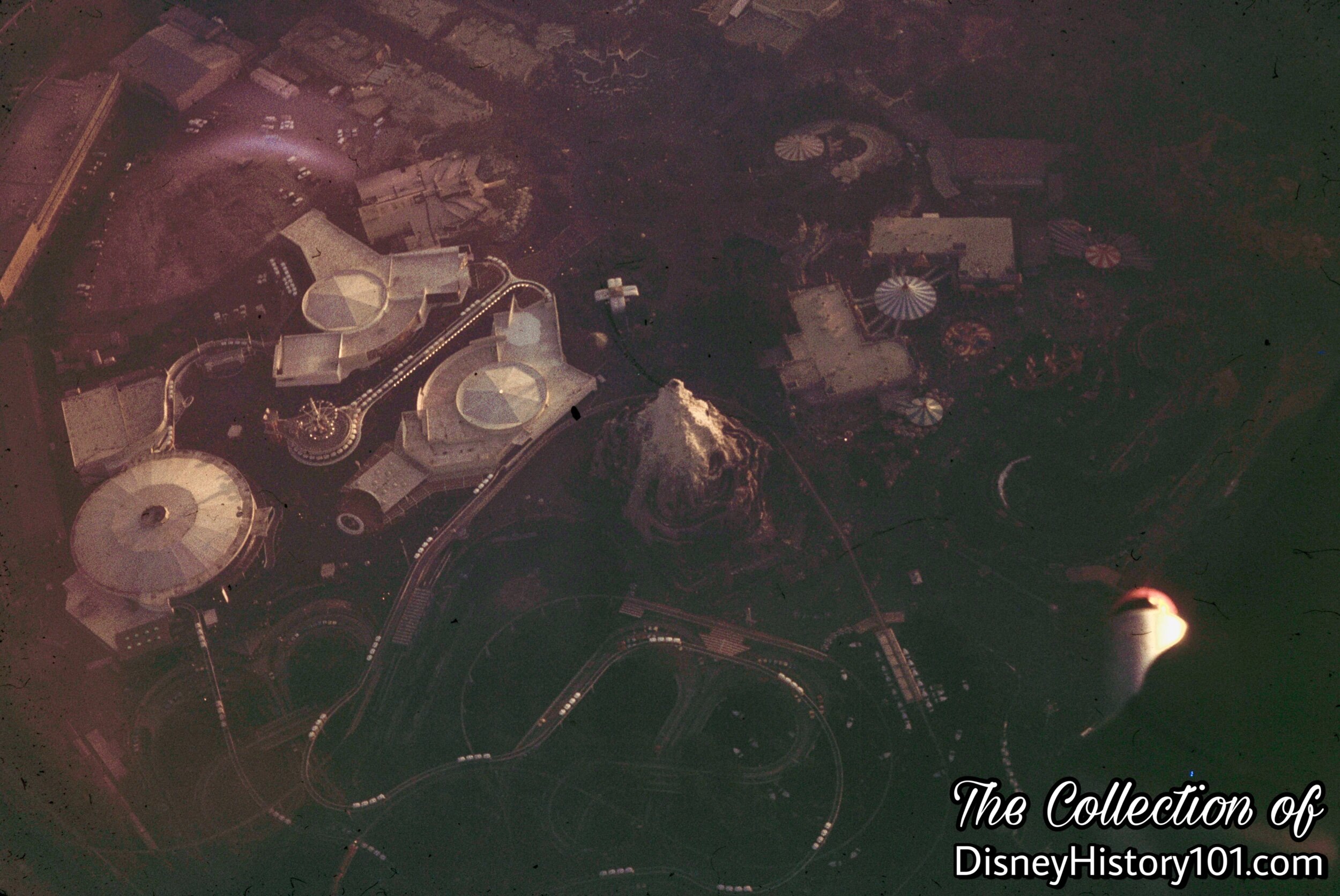
One publication once stated that “from the air, we can get the clear layout of Disneyland in our minds”. Passengers of Los Angeles Airways’ helicopters received a fantastic aerial view of Walt Disney’s “magic kingdom” in Anaheim. Maybe you can point out Monsanto Plastics Home of the Future, the PeopleMover’s tracks, or the Matterhorn (“the highest point in Disneyland”) from this height.

“Los Angeles Airways - Flying High”
The July 1962 issue of FLYING carried significant news for commercial aviation and the general public of the greater Los Angeles area! The cover touted the commercial airline Los Angeles Airways, who had become the first civil operator of a fleet of five $650,000 Sikorski S-61s back in March. These new commercial twin-engine, turbine-powered helicopters came with an increased payload capability, and several new safety features that allowed for all-weather operation. One of the main safety additions was partially housed into the Main Rotor Blades themselves. These Main Rotor Blades were filled with compressed air at the Sikorsky plant, so that (if the blade was later damaged, and the slightest pressure lost), a warning was given through the Pressure Gauge before lift-off.
Los Angeles Airways soon officially inaugurated its Sikorsky S-62 turbocopter service - the third generation of Sikorskys to service L.A.A.! Each helicopter carried nine passengers, had the capability to cruise at 100 miles per hour, and offered a range of 285 miles. In addition, these new turbocopters could land on water (or any service) in case of emergency, and could carry a 90% greater load than Los Angeles Airways “piston-powered S-55s, for the same fuel cost at 28% higher speed”.
Yes, this was the “high point” of classy commercial flights to and from Disneyland!

Helicarrier services courtesy of Sikorsky passenger helicopters were really “taking off” in major cities during the 1960s. A little less than 3,000 miles away from Disneyland, a civilian Sikorsky S-61 Sightseeing Helicopter lands atop the Port Authority pavilion at the 1964/1965 New York World’s Fair!
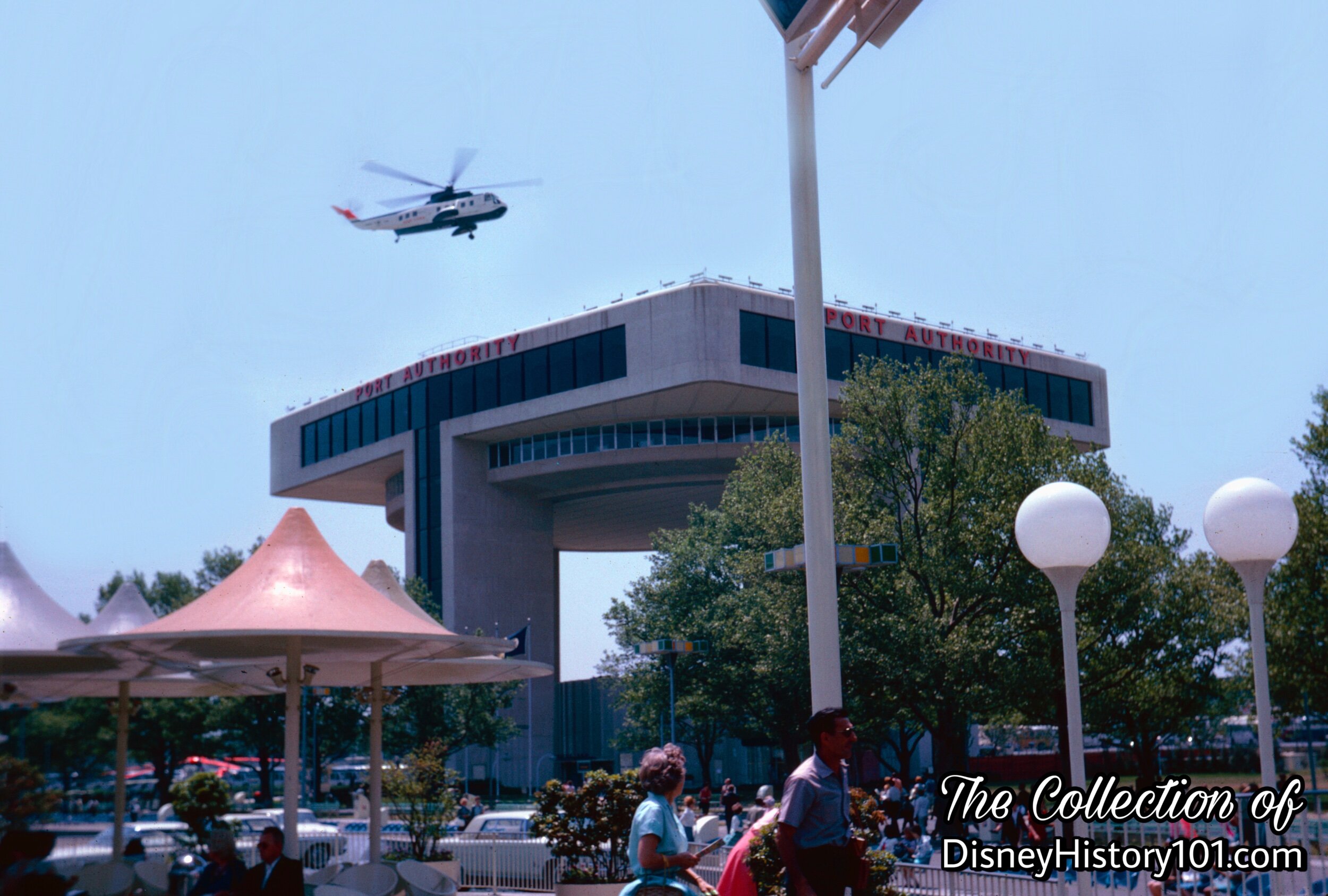
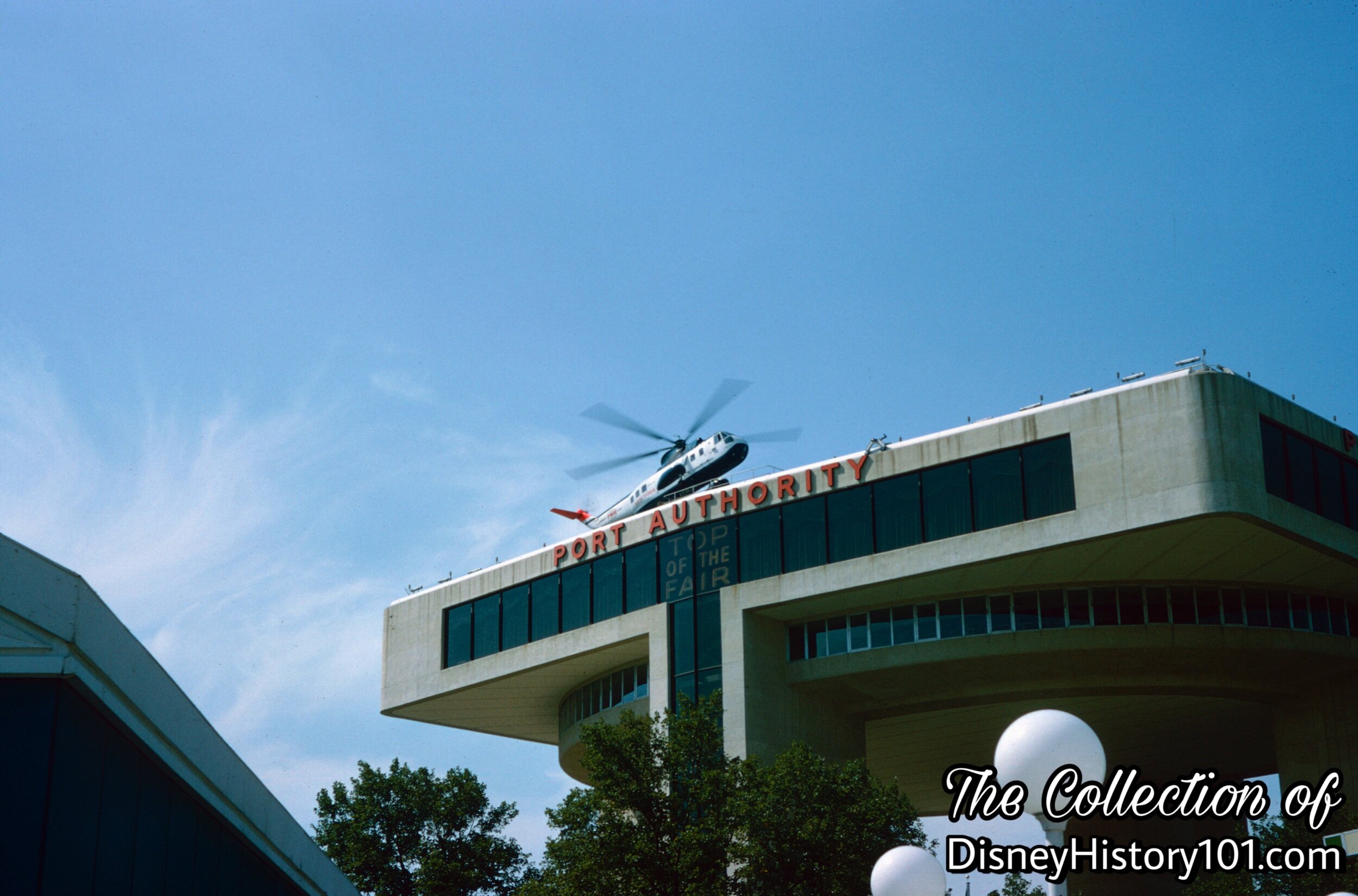
We’re here because, once landed, we’re afforded a brief peek inside its cabin.
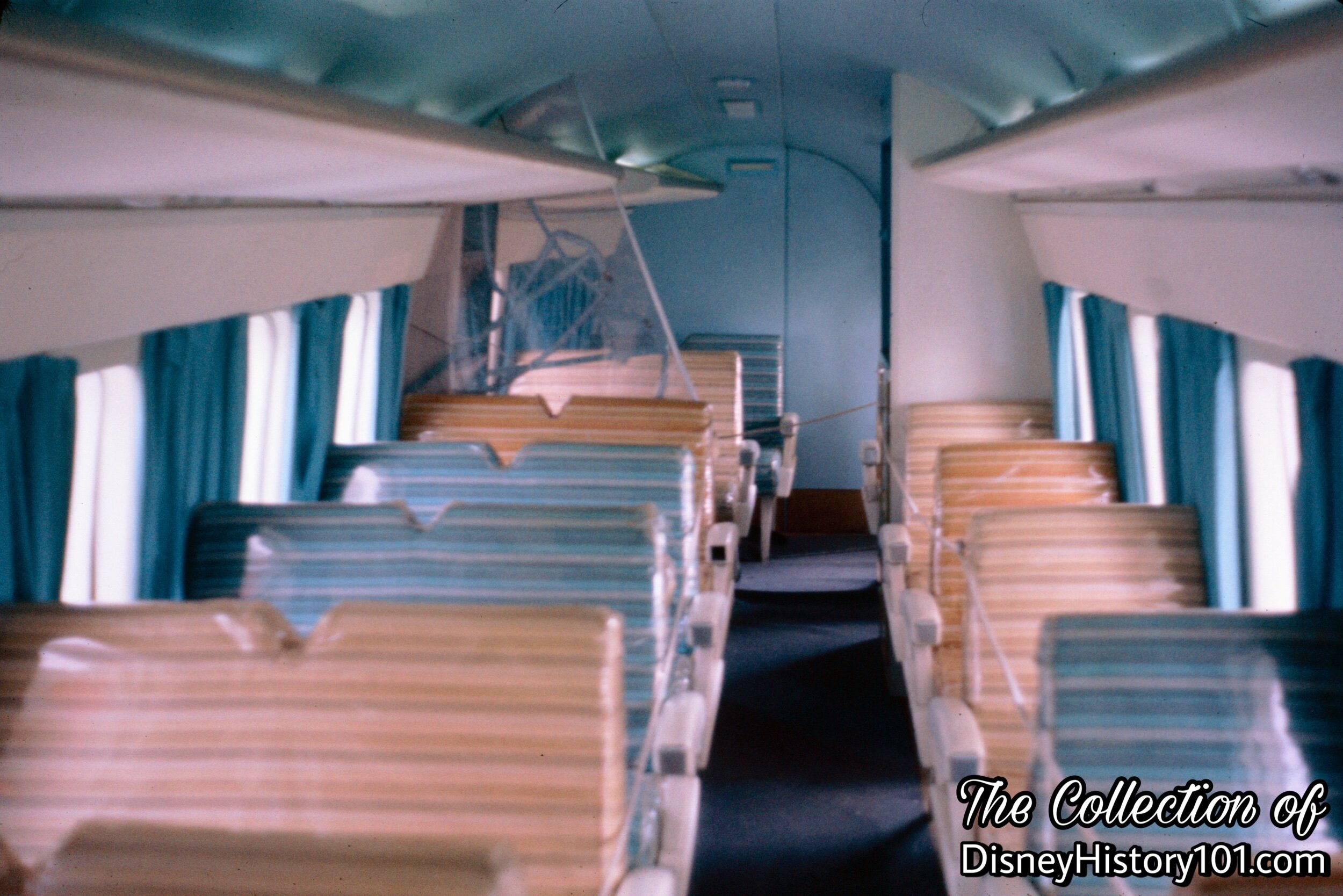
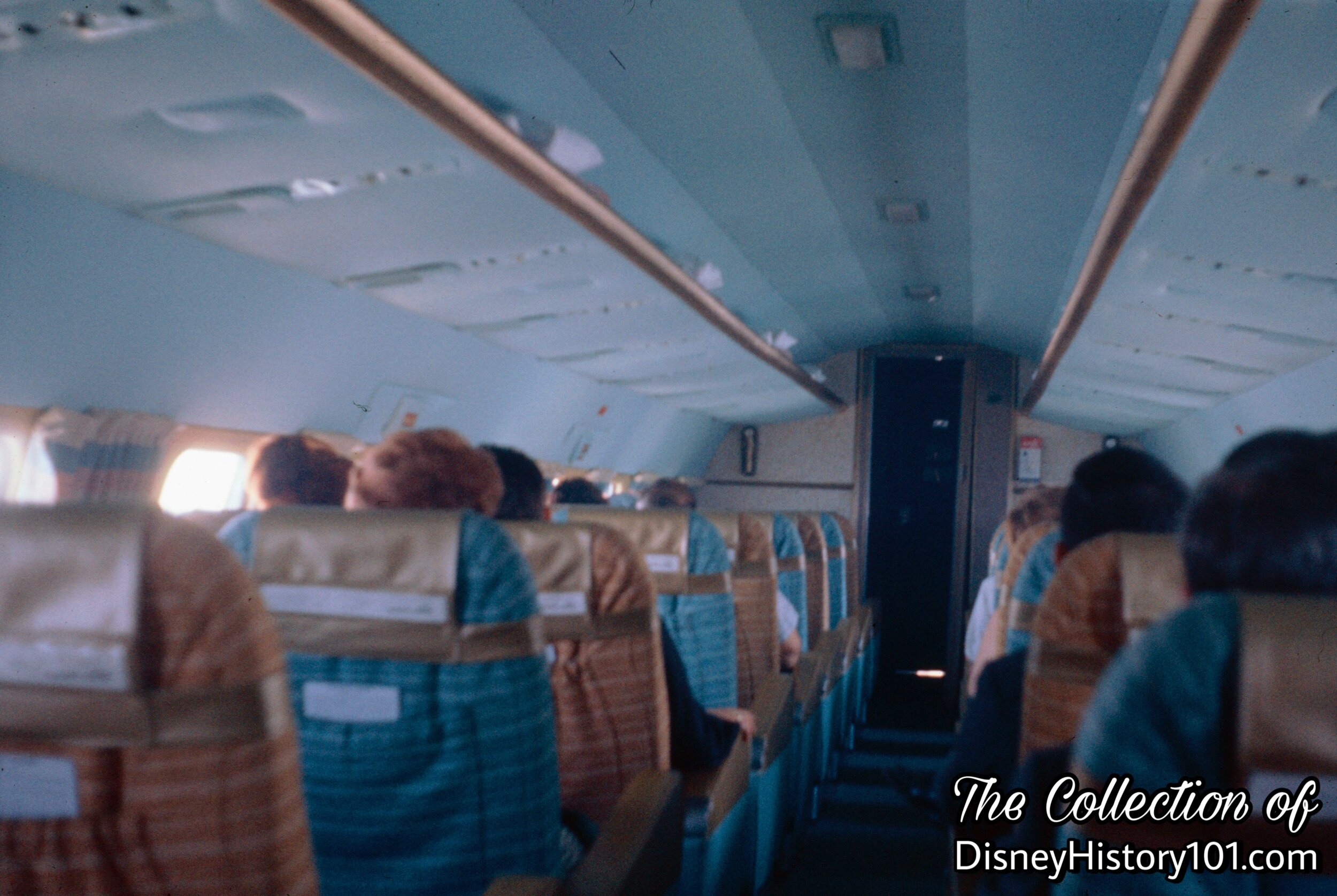
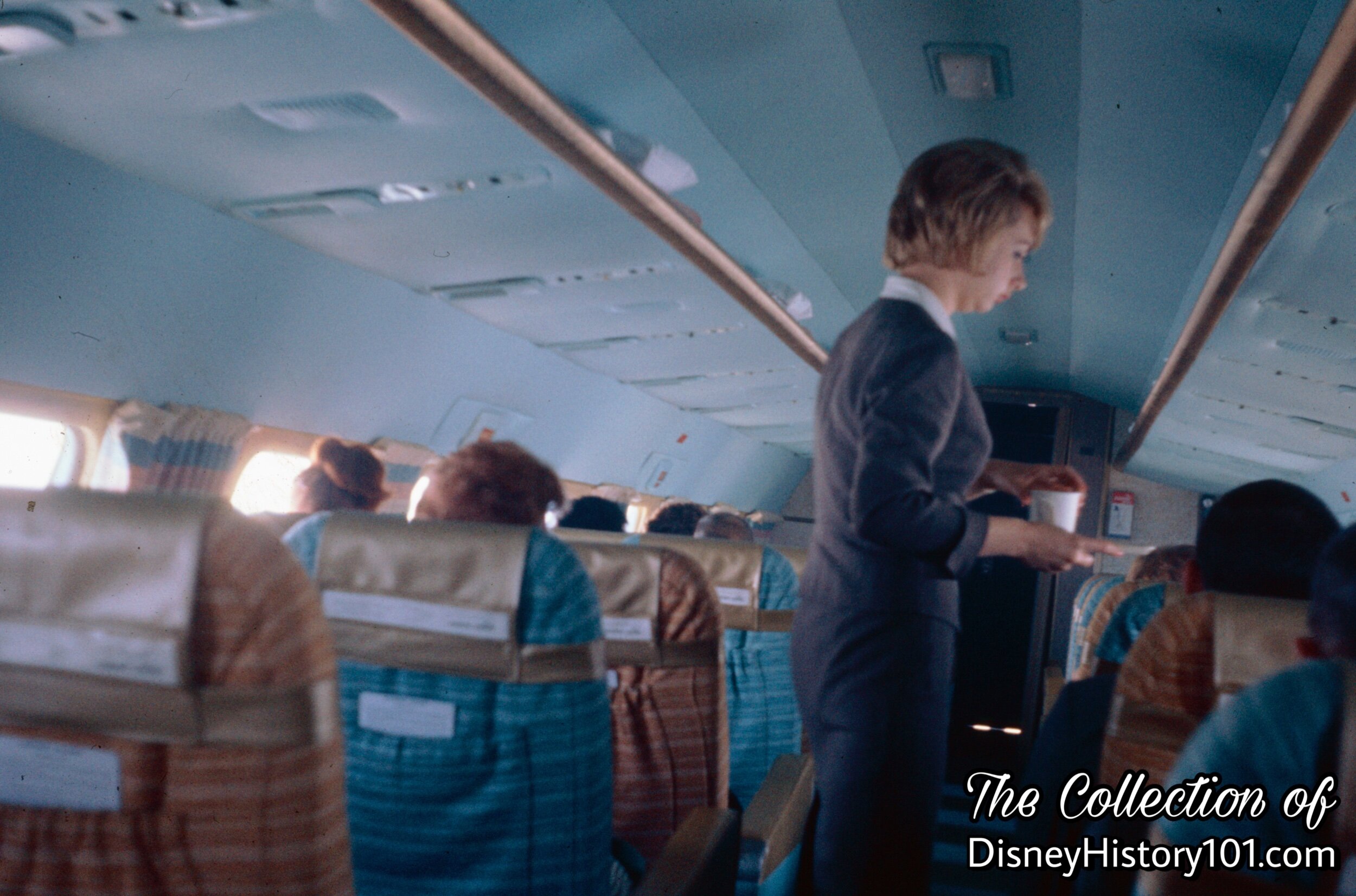
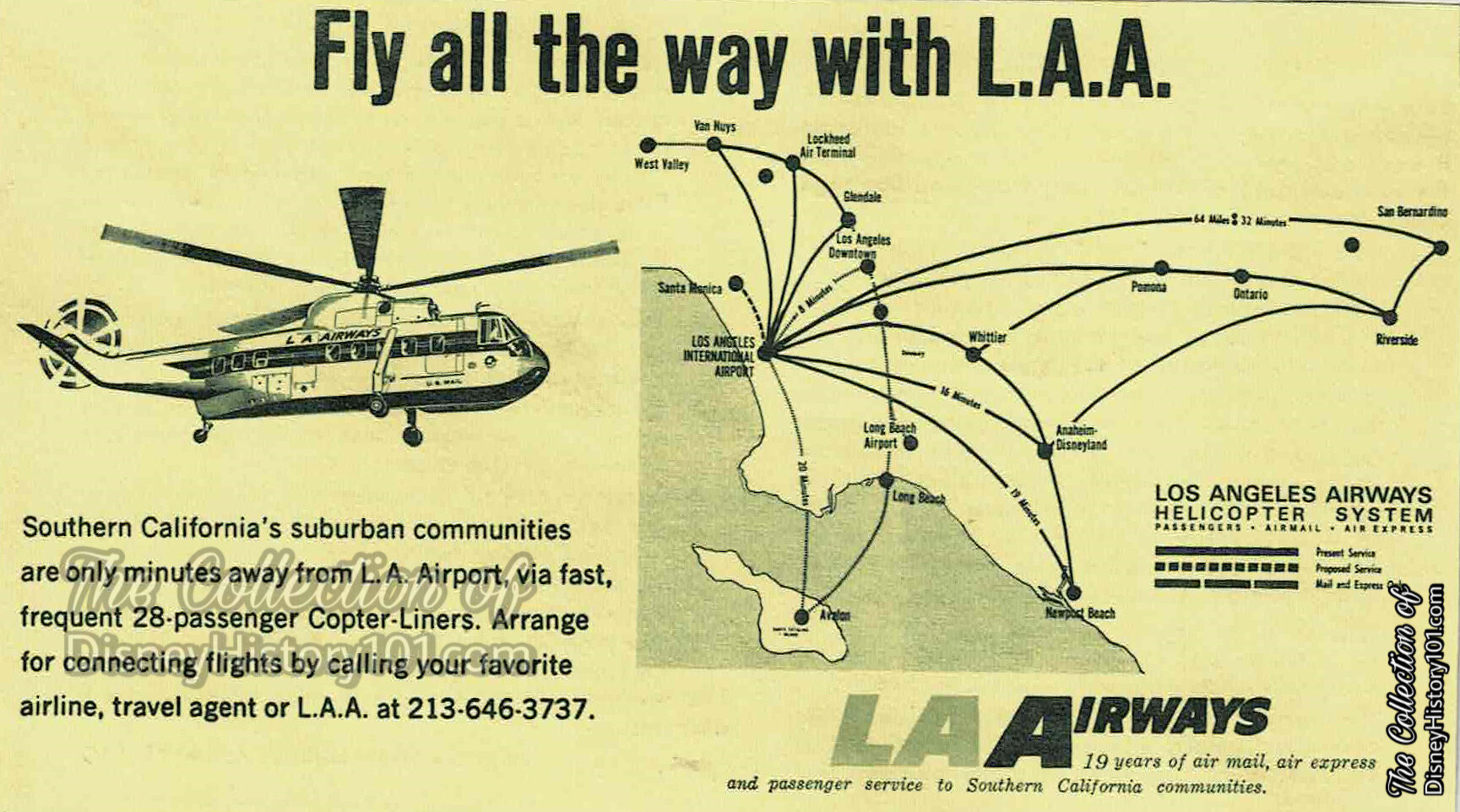
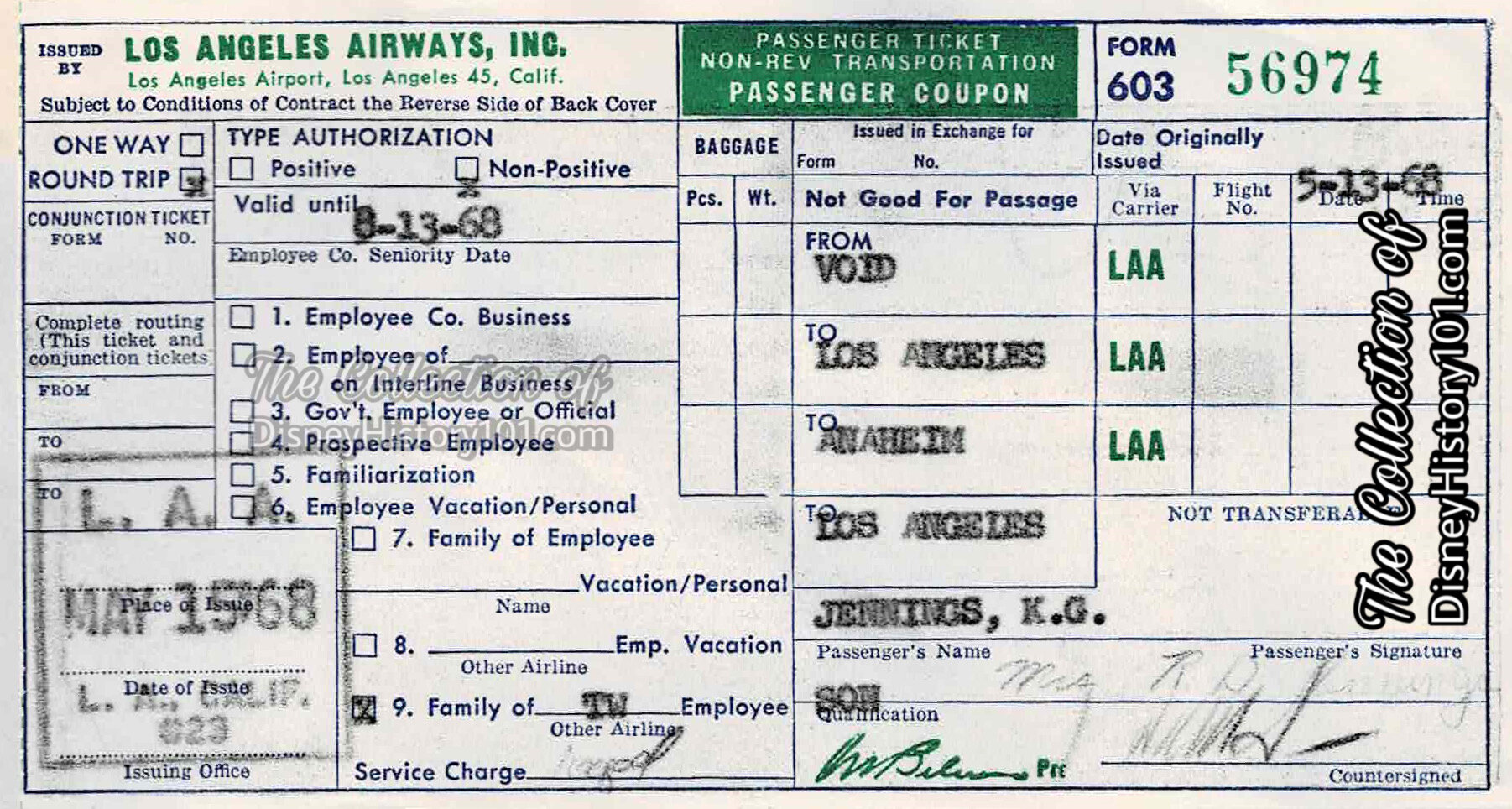
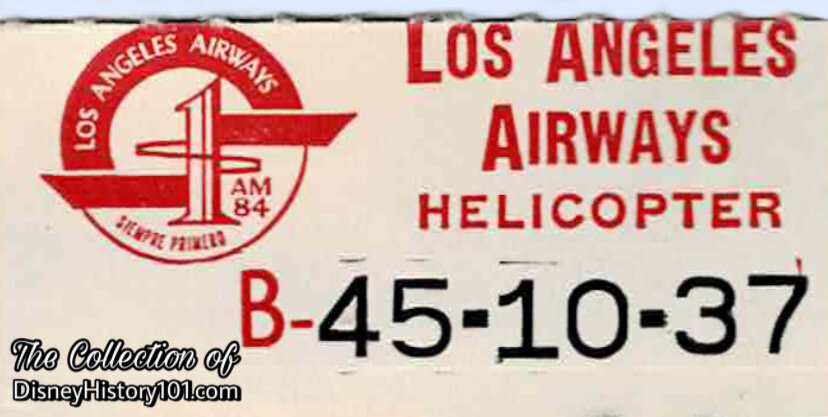
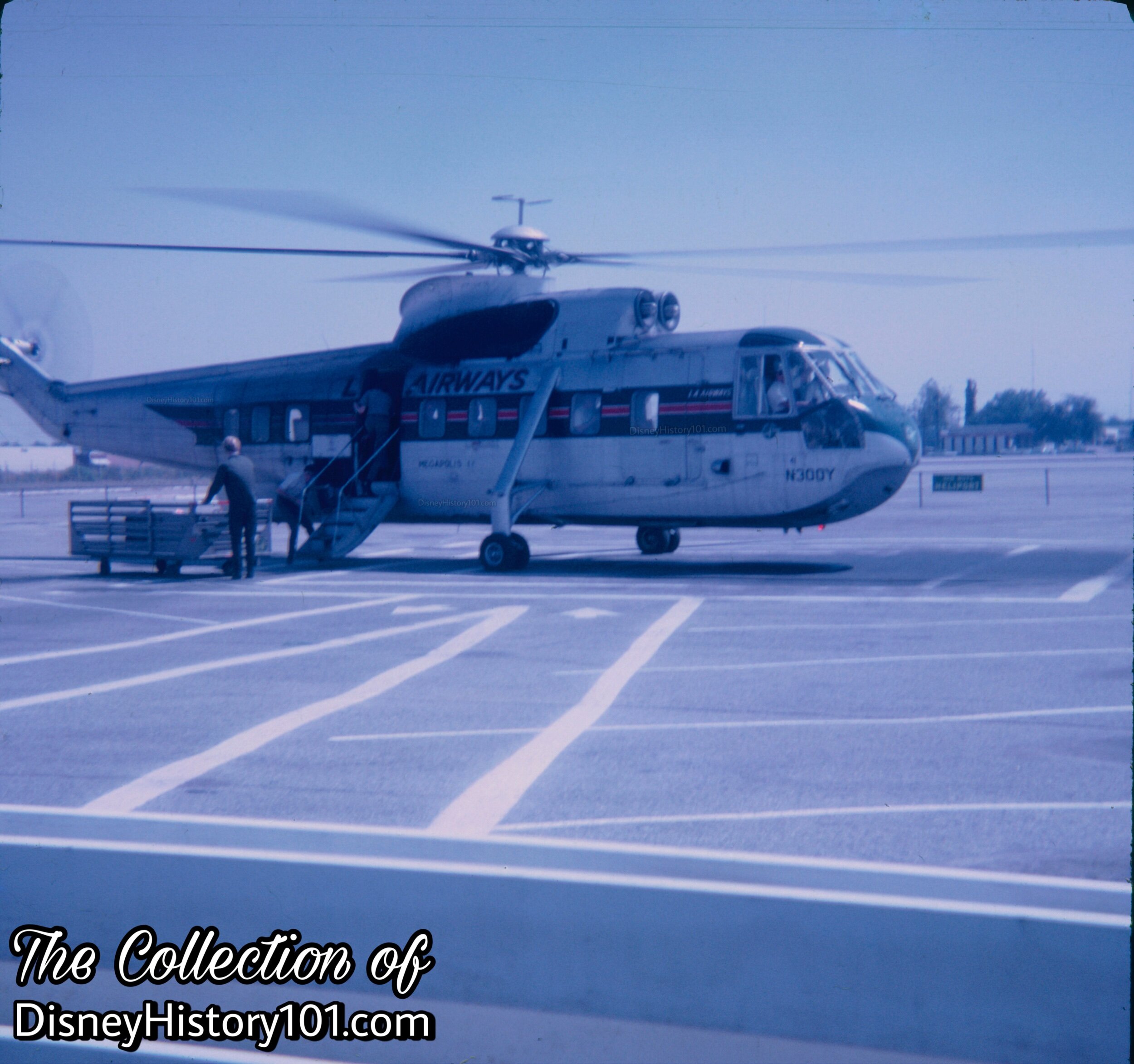
“The Tragic Flight of Los Angeles Airways 61031”
However, just five years after the aforementioned photograph was taken (and after twelve years of service to Disneyland), something terrible would happen that would end this form of transportation to the happiest place on earth. The demise of Los Angeles Airways flights to Disneyland came when one Sikorsky 61L (registration number N300Y, serial number 61031) was involved in a fatal crash on the evening of August 14th, 1968.
Tragically (and mournfully), eighteen passengers and three crew members lost their lives, while en route to Los Angeles International Airport from Disneyland. Mechanical failure was determined to be the cause of this devastating and horrific crash. The National Transportation Safety Board specifically attributed the incident to “fatigue failure of one rotor blade, which resulted in separation of the blade”. The helicopter could not be controlled and quickly fell from the sky. It is unclear if negligence was involved, if the sensor malfunctioned, or if the stress and failure was undetected and sudden. Whatever the case, countless lives were affected and changed forever by this catastrophic event. From 1951 to 1968, there hadn’t been any notable incidents involving commercial Sikorsky helicopters. However, during 1968 there were two situations resulting in many fatalities (the aforementioned one, and another Sikorski S-61L in Paramount). Both of these Sikorskis were in the service of Los Angeles Airways.
“The End of An Era”
Disneyland Guest Hotel Directories continued to list the telephone extension for Los Angeles Airways up to September of 1970. However, not even Golden West’s “eleventh hour” attempt to acquire Los Angeles Airways could save the helicopter commuter airline from what would happen next. The deal fell through, and would result in the demise of Los Angeles Airways airline operation during 1971. Golden West would only briefly take over helicopter operations for a mere five more months, but it was the end of an era (not only for Los Angeles Airways, but) for helicopter flights to and from Disneyland. By the summer of 1971, Vacationland magazine (published three times yearly by Walt Disney Productions and distributed to more than 1,500 hotels, motels, and leading tourist attractions) had stopped advertising Los Angeles Airways’ “Helicarrier service” among the public transportation alternatives serving Disneyland.
However, this wasn’t the end of Igor Sikorsky’s Sikorsky Aircraft Corporation (which was the world’s first mass-producer of helicopters, since 1942). They would go on to manufacture many aircraft designs, such as its 61-L. This particular model is still utilized for military, industrial, and civilian applications to this very day!
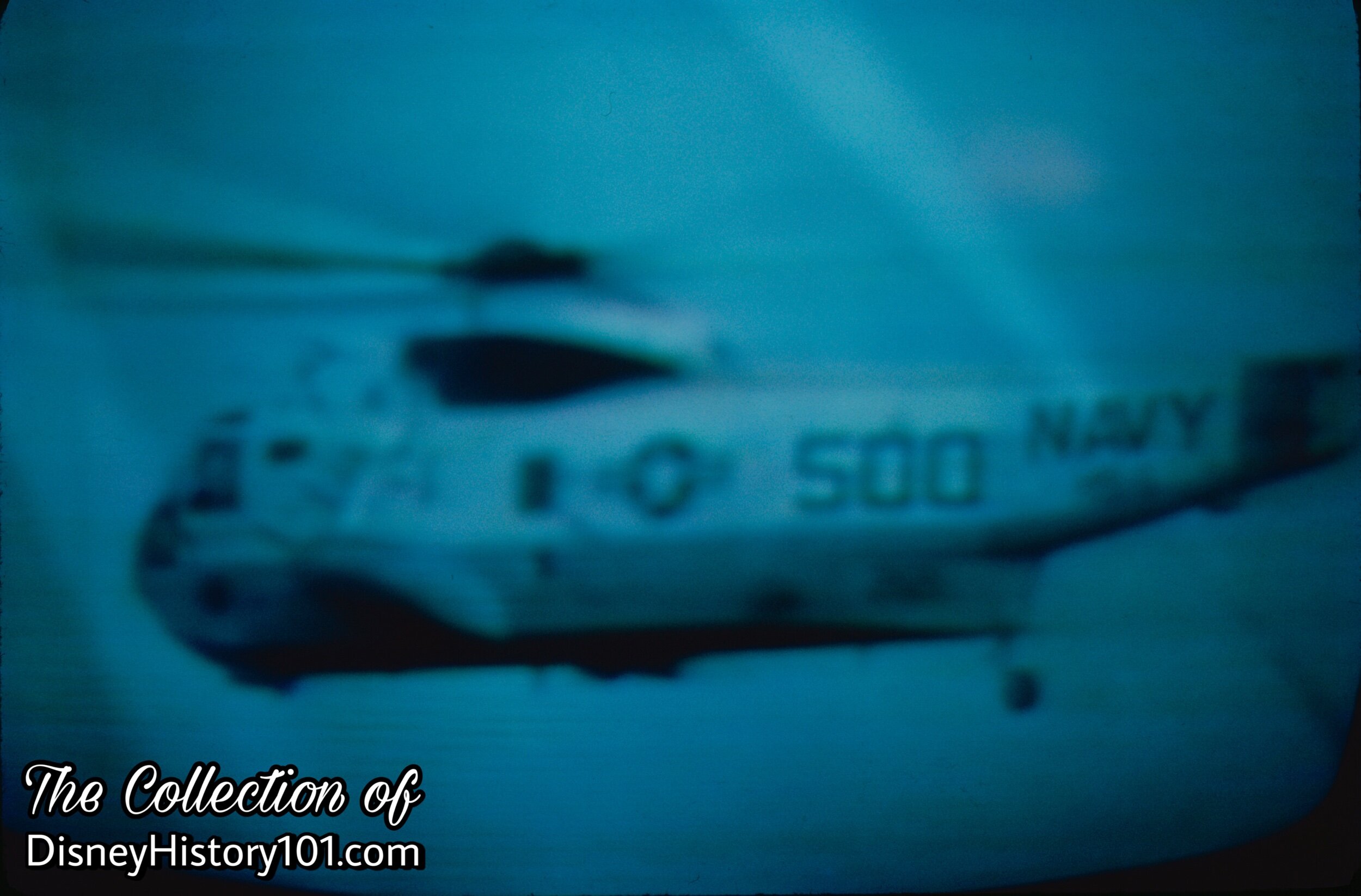
Notwithstanding the tragic commercial incidents, the Sikorsky continued a trusted helicopter manufacturer by the greater public opinion. In fact, their aircraft was in use by the United States Military, some local government agencies, and businesses since the 1940s. This military Sikorsky image was captured during a test flight, c. late 1960s.
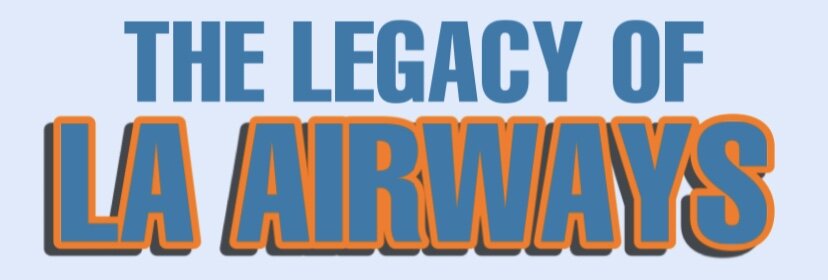
Other commercial helicopter companies (like AirSpur) continued to offer service from select Southern California airports to the vicinity of the MAGIC KINGDOM®. AirSpur’s state-of-the-art 30 Westland helicopters were IFR certified and powered by Rolls Royce GEM engines. The headline which accompanied this photograph described these modern commercial helicopters this way :
“Designed especially for AirSpur’s passenger service, the Wetland 30s afford wide-body airline comfort, approximately six feet of headroom and ample storage for luggage underneath the 16 passenger seats. The helicopter’s capacity permits all passenger luggage to be hand carried aboard or routed and interlined by AirSpur to connecting flights.”
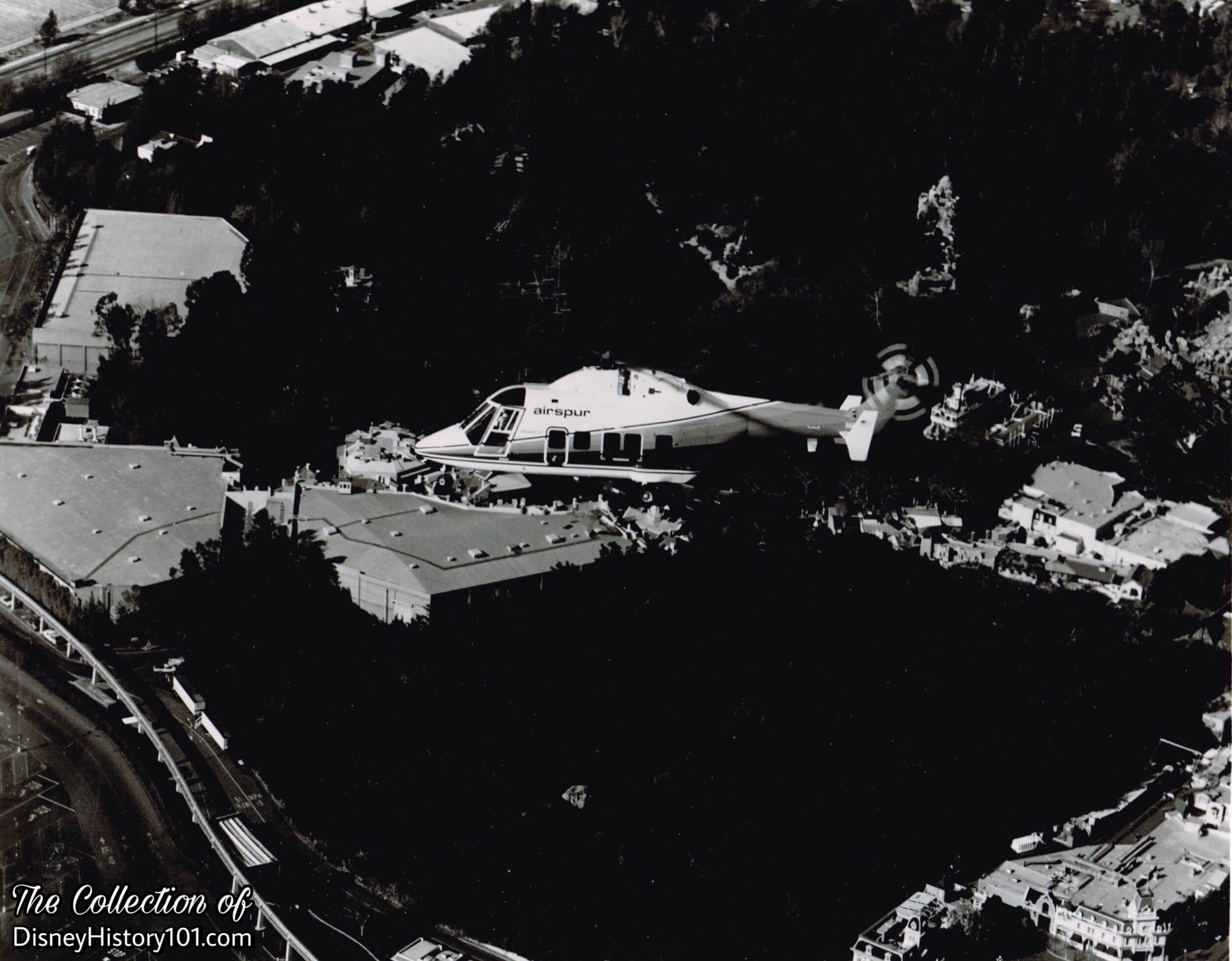
Though AirSpur’s sophisticated helicopter made passes over Disneyland, the days of the Disneyland Heliport were just a memory a bygone era!
The helicopters returned to Disneyland on Saturday, January 26, 1991, as The Disneyland Hotel northern Parking Area hosted “Helicopter Awareness Day,” “which was organized by the ‘Professional Helicopter Pilots’ Association and the Helicopter Association International.” A mini-tower was set up to direct the traffic - “three military helicopters…two were shipboard copters from the Navy, and the third was a sea rescue craft from the Coast Guard. Thirty local police, fire, rescue, medical and news team crafts were on static display. Approximately 6,000 people in attendance got the chance to examine the crafts and chat with the pilots, which included Commander Chuck Street, who brought KIIS FM’s ‘Yellow Thunder,’” according to Disneyland LINE Magazine (Vol. 23, No. 6 ; February 8, 1991).
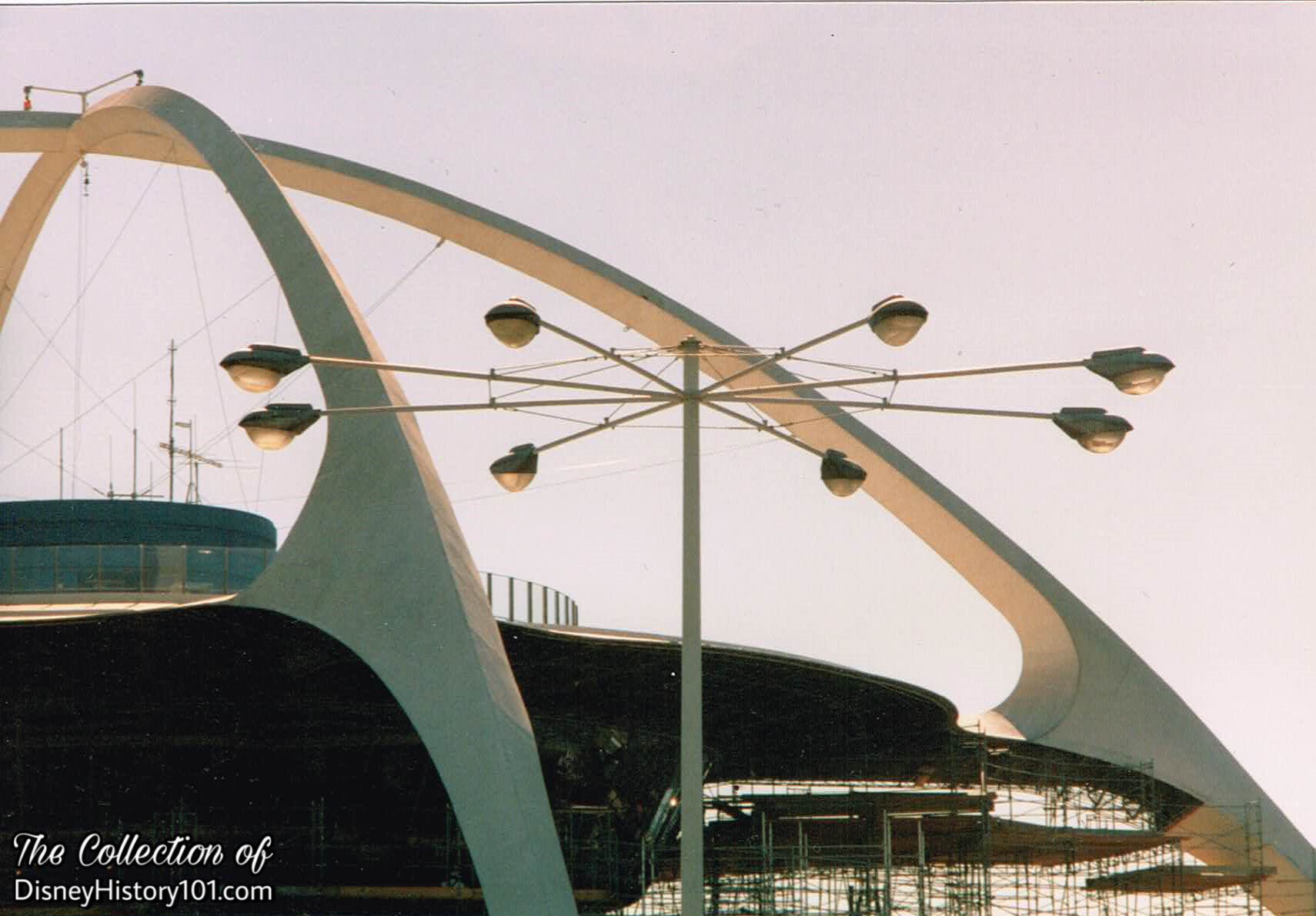
Here’s one more Disney and Los Angeles Airport connection. During the heyday of Los Angeles Airways, this was at the center of the destination. The Theme Building (and its restaurant) was designed in 1959 (with the help of Dorothea Holt Redmond), and dedicated in 1961.
Decades later, the Walt Disney Company’s story and LAX would cross paths. A $4 million renovation of the Theme Building (courtesy of Walt Disney Imagineering), brought the Encounter Restaurant to the airport facility in 1997.
MAXWELL COFFEE HOUSE (HILLS BROS. COFFEE HOUSE (& COFFEE GARDEN & AMERICAN EGG HOUSE)
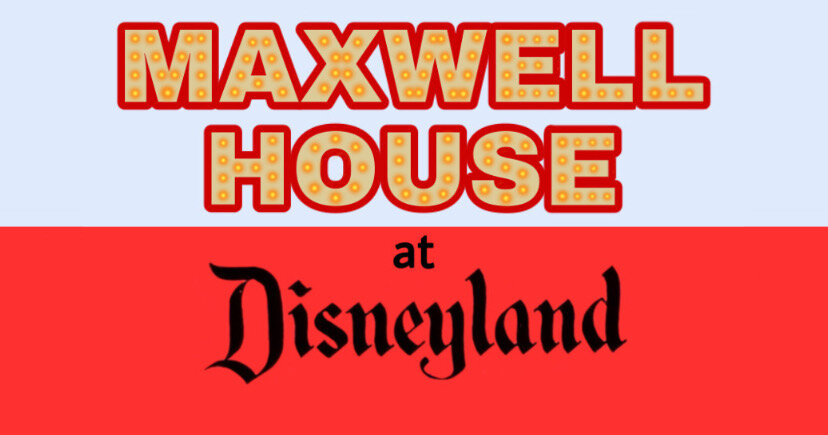
“Let’s dine at Disneyland,” on the 600 block of Main Street U.S.A.), in Town Square at Disneyland® Park!
“Participant Sponsorship”
Our story begins in 1951, when Walt Disney and Art Linkletter visited the famous entertainment complex Tivoli Gardens in Copenhagen. He was researching and talking notes to build a family entertainment center and Tivoli was much like what he envisioned. It was clean, directed to the entire family, fun, entertaining and educational. Walt noted how important it was to have a lot of places for guests to sit down and a wide variety of eating spots that served excellent meals.
Fast forward to 1954 when Walt was searching for participants to lease shop and restaurant spaces at Disneyland, and help generate the necessary capital to fund construction of Disneyland. In a synergistic relationship, the companies (in turn) could sell their products and advertise their corporate names in the Park. Disneyland Participant Corporate Sponsors were carefully selected. High quality, long term corporate sponsors would provide incremental income that enabled Disneyland to enhance its show and attractions, offset some operating expenses, and capitalize on marketing opportunities.
Several of these turn-of-the-century pioneers, “reliable old firms” sponsored the “abundance of restaurants devoted to pleasing all tastes and all budgets,” according to “The Story of Disneyland,” published 1955. Ultimately, Maxwell Coffee House Division of General Foods became one of those forty-seven lessees to sign a contract with Walt Disney Productions (regarding creating happiness at Walt Disney’s Disneyland)!
It was estimated that the table service facility would have the capacity to serve about 400 guests per hour. Despite the fact that Maxwell Coffee House Restaurant did not open in July of 1955, it became reckoned among Disneyland’s twenty eating facilities which were predicted to contribute to accommodating “15,000 persons daily, hitting a peak of 60,000 o holidays and week-ends…” and one of “twenty restaurants and snack bars, capable of saving 8,000 hourly,” at least according to “Building A Dream” (prepared by the Disneyland, Inc. Public Relations Department). Years later in 1958, Bank of America appraisers figured of the total income received from leases, 16.02% was derived from the selling of advertising rights and 40.12% from the leasing of space to concerns whose main reason for occupancy is for advertising purposes. The remaining 43.86% of the lease income was derived from stores that sell various products and food. It is this income that supported the construction and growth of Disneyland. Clearly, these participant corporate sponsors were not here to make money, but to create happiness!
“Initial Concept Designs by Disneyland, Inc.”
According to “THE DISNEY THEME SHOW - an introduction to the art of Disney outdoor entertainment: Volume II”: Of all the guests’ senses that come into play at Disneyland, the most difficult response to predict was taste. If 70,000 guests were to arrive on a single day, there would probably be 70,000 different ideas about food. Generally speaking, Disneyland food locations fall into three categories - sit-down restaurant service, “buffeteria,” and fast-food categories. The most extensive theming has always been found in the sit-down restaurant locations but all locations were housed in authentically motified facilities.
As Walt described to Bob Thomas (of Associated Press), “some industries will have exhibits, but all of them must be in keeping with the era.” Soon (c. 1954-1955), Sam McKim (with audiences in mind) and possibly other contributing artists were creating designs for the Maxwell Coffee House Restaurant Show Building Facade. This building would camouflage a construction wall.
Early thumbnail sketches and other concept artwork of Disneyland seemed to be unencumbered by restrictions of budget, schedule or the laws of nature and physics. Though guided by Walt, his artists appeared to engage in “free-thinking,” as if implementing the modern “Blue Sky” Imagineering process. Like some advanced “High Concept,” final designs were quickly generated and approved.
Next, architectural drawings helped define all designs, production and construction strategies, costs, schedule, and resource requirements. “Disneyland is unique in that some of the world's foremost creative artists and architects control all design at Disneyland.“ Models explored the various dimensional relationships, site-lines, flow patterns, ergonomics, and visual appeal to convey the desired creative intent.
“Architectural Designs by Lessees”
Disneyland, Inc. printed materials for Lessees detailing specifications for architectural designs of exhibit spaces. These were revised by March 16, 1955 and issued to Lessees.
All of the interior architectural drawings were done by competent registered architects or an approved display house of the lessee's choice. All of the designs submitted by the lessee's architect, whether for buildings or construction of interiors in DISNEYLAND, were approved as to the theme and general plan of DISNEYLAND as established by WED Enterprises, Inc.
Three sets of preliminary drawings were furnished DISNEYLAND, Inc. as soon as possible after signing of the lease. Two sets were retained by DISNEYLAND and one set was returned to the lessee’s architect with any revisions noted thereon and stamped “APPROVAL TO PROCEED TO FINAL DESIGN.” This stamp when properly signed and dated constituted the lessee’s authority to proceed with the final drawings.
The Lessees revised their final drawings to incorporate any revisions noted on the approved preliminary drawings, and submitted three sets of the revised drawings to DISNEYLAND. One set was returned to the lessee’s architect and any revisions noted thereon are to be incorporated on the original drawings. When the lessee had incorporated the final revisions on the drawings, two sets of transparent ozalids were forwarded to DISNEYLAND for approval. DISNEYLAND would stamp both sets “FINAL DESIGN APPROVED” and “LESSEE’S CONTRACT DRAWINGS”, and return one set to the lessee who could then release drawings for bid and/or construction.

“Construction”
“When the giant earth-moving undertaking was completed, the building crews took over. Soon, the rat-tat-tat of riveters was shattering the air, and sparks were flying from welders’ torches as the steel frameworks, capable of withstanding the ravages of time and the elements rose above the newly formed ground. While carpenters hammered and masons laid row upon row of brick and stone and mortar, the permanent buildings began to take shape and form,” according to “The Disneyland Story” published 1955. One of the first buildings to be constructed was the Main Street Opera House, which was used as the Mill. Here, the woodwork of Disneyland was generated - from the functional to the aesthetic! Approximately three and one-half million board feet of lumber went into the Park’s construction. Much of the wood was processed here by McNeil Construction (which formerly constructed Walt Disney Studio sound stages in 1947 and 1953), and under the direction of George Mills Sr. (the Prime General Contractor and Mill Foreman).
Then, under the direction of Joe Fowler (Construction Supervisor), as well as Charles Alexander and Ray Conway (Construction Field Supervisors), the lumber was soon fashioned into the framing belonging to the very first buildings constructed at Disneyland - primarily the Main Street Complexes (on each side of the street).
In constructing each building, a concrete foundation and slab floors were prepared, followed by wood frame construction (while store units would have a combination wood and rigid steel frame). ”The first fabricated steel for the Main Street buildings arrived November 8 and was erected,” according to the narrator of “Disneyland - The Park,” a Disneyland anthology television series excerpt, first aired 1957 and Disneyland LINE (November 22, 1979). The roof covering was a variable, dependent on the architectural design.
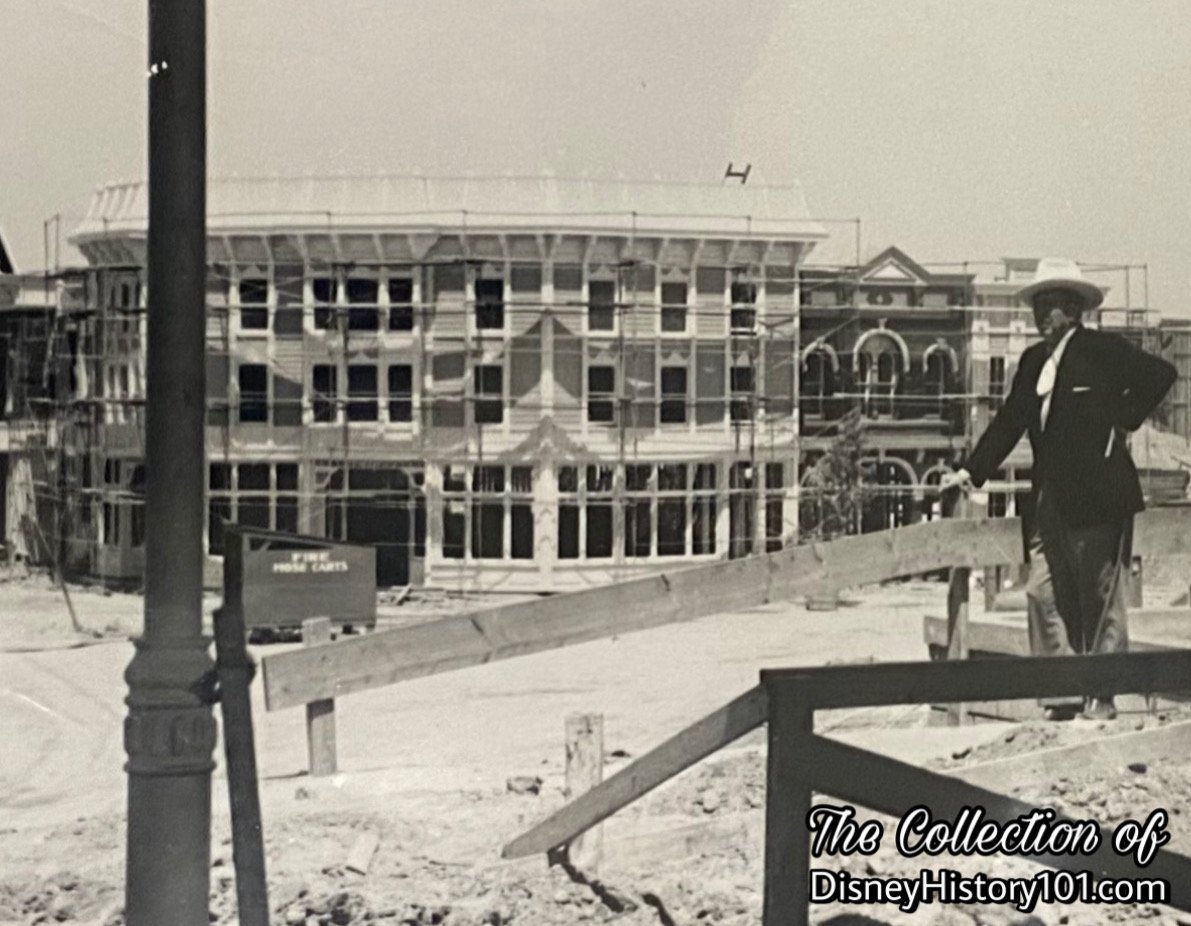
As of June 2, 1955, C.V. Wood Jr. sent an Inter-Office Memorandum to Walt Disney regarding the best estimates that could be obtained at the time regarding the completion status of individual sections of the Park and Opening Day. C.V. wrote: “Building #612 - Maxwell House. Will not be completed. We will have to dress. Electric Signs: All are in work - with the exception of the shoe store and the Bank of America, all will be completed.“
The building (as each on Main Street U.S.A.) possessed complete fire sprinkling systems. By June 30, 1955, related Disneyland Site Work Fire Protection Utilities Plot Plans were prepared for Disneyland Inc., by J.E. Thomasson of WED Enterprises Inc.
All fixtures were placed in their correct motif and many light fixtures of Disneyland were authentic antiques. The Disneyland News added: “From its wrought iron and old stonework exterior to the patio-type serving area, the Maxwell House represents all that was fine and gracious in turn-of-the-century life in the New Orleans section of the Old South. Built to resemble a hotel of that time and place, it offers a jewel-like lobby sumptuously dec orated with crystal chandeliers and velvet and plush furnishings. Past the lobby is the intimate coffee shop, serving coffee and pastries. Although indoors, the coffee shop ceiling fades away to a midnight blue and stars twinkle above.”
The wrought iron work and staff work was also performed right on the jobsite by Lawrence G. and Bruce McNeil’s forces.
Food service equipment was provided by Coast Distributing Company of Los Angeles (who ran a “Congratulations” message to Walt Disney and Staff in “The Disneyland News”, Vol. 1, No.2 ; August 10, 1955).
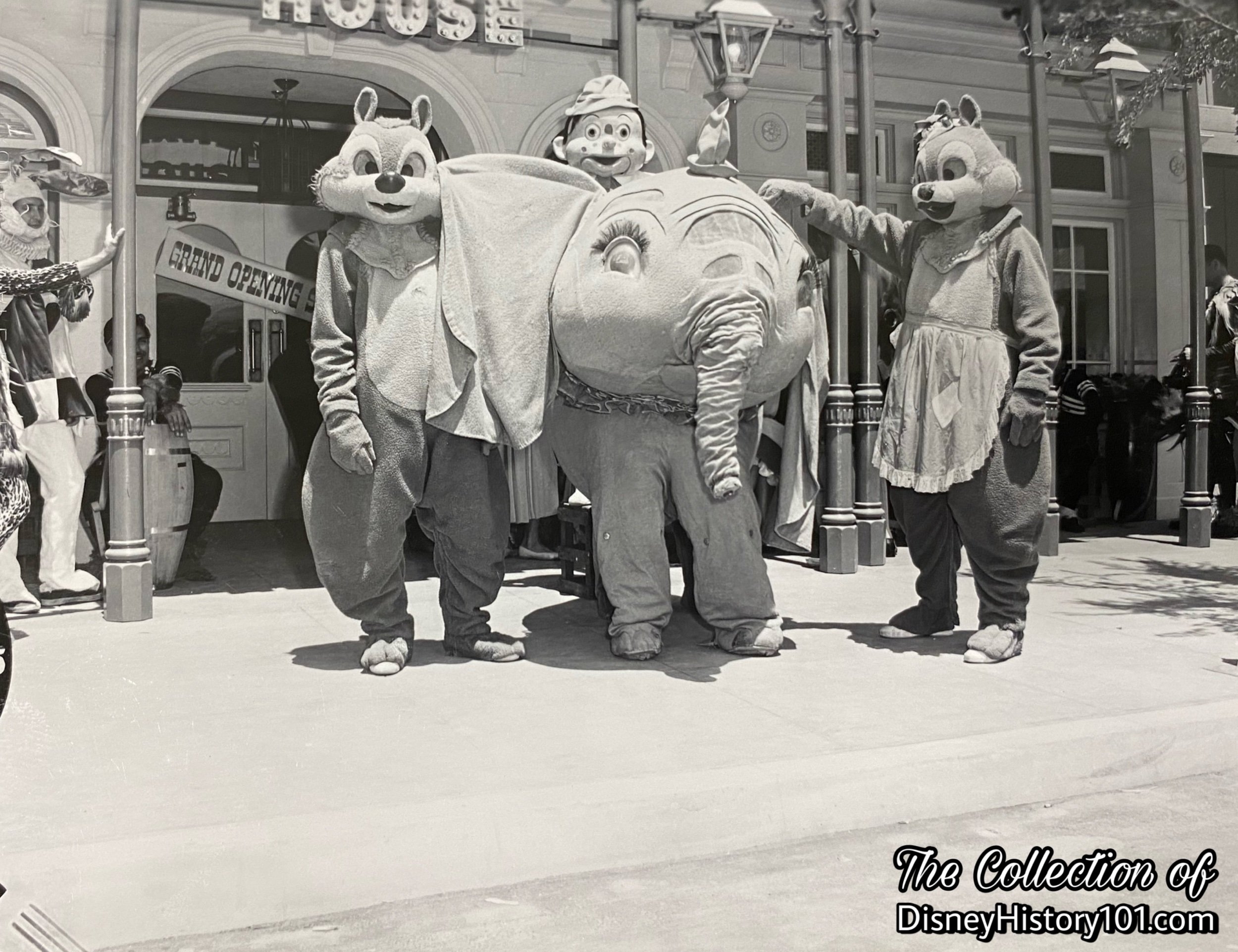
“The Press Preview Day of Disneyland”
Bob Milek recalled: “Opening day was very exciting...a big parade with movie stars…and I took pictures from the roof of Hills Bros.” But Maxwell Coffee House was not ready by July 17, 1955. Disneyland Mill Foreman Scotty Cribbes remembered: “On opening day, I was walking down Main Street with a cup of coffee in each hand, when I ran into Walt Disney. Walt stopped me and I thought I was going to be fired, but Walt just wanted to know where HE could get a cup of coffee!”
In the meantime there were several places that served Maxwell House coffee. In a move of corporate synergy, the fabulous Disneyland exclusively served Maxwell House Coffee at 16 eating locations (i.e. Aunt Jemima’s Kitchen, UPT Food Stands, Carnation Ice Cream Parlor, Chicken Plantation, Railroad Station, Red Wagon Inn, Space Bar, Pirate Ship, Frito House, and the Tropical Saloon, to name but a few). The price for a cup of coffee? Maynard Swenson recalled that “Coffee was 5¢ a cup then!”
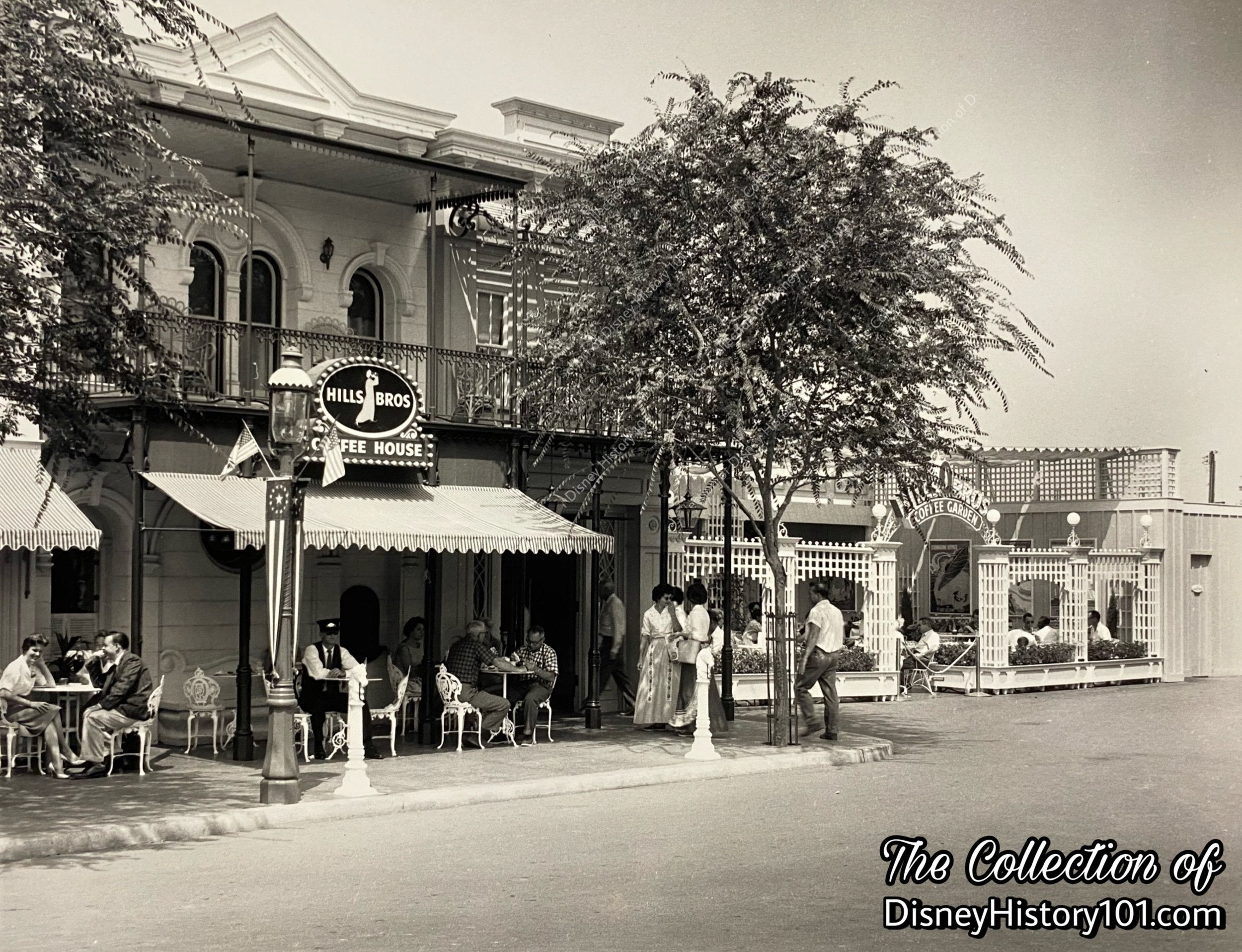
“The Maxwell Coffee House Grand Opening”
After Disneyland opened, the Disneyland News (of August, 1955) began advertising a Maxwell House opening soon in Disneyland. One advertisement (published in The Disneyland News, September 1955, page 22) announced that the Maxwell House would open soon on Main Street U.S.A.! It would be a few more months before the official opening occurred on December 1st, 1955, to “all the excitement of a Hollywood premier,” with “celebrities from the business and entertainment world” joining Walt Disney and Russell Kramer, General Manager of the Institutional Products Division of General Foods! “Some 1000 American Hotel Association conventioners were also on hand to mark the event, guests of General Foods and Maxwell House for the evening.” According to another headline added, “Televisions stars Eve Arden (‘Our Miss Brooks’), Spring Byington, and Dean Miller (‘December Bride’) were on hand to assist with the opening.”
Guests had the opportunity to meet “The Greatest Guy In The World, the Man Who Takes His Family Out to Dine, central figure in General Foods’ national advertising - the most dramatic promotion in the history of the food service industry,” according to The Disneyland News (Vol.1 -No.6 ; published December 10, 1955).
Marcy Smothers (in her book “Eat Like Walt - The Wonderful World of Disney Food”) adds that Walt attended “though he had a terrible case of laryngitis. Despite buckets of rain, the cancellation of the planned parade, and the postponement of Walt’s award as the ‘Greatest Guy In The World’, the dedication ceremonies in Town Square went off without a hitch. Following the ceremonies, two hundred of the Guests boarded the train at the Main Street Station for the brief ride to the Frontierland Station, while others followed the Disneyland Band to the Plaza. Everyone came together again for dinner and entertainment at the Chicken Plantation Restaurant. Maxwell House VIPs were then treated to an after-party at the Red Wagon Inn.”
The story “New Maxwell House Graces Main Street” covering the opening of the new Maxwell Coffee House (and the full-page advertisement “Maxwell House Welcomes American Hotel Association”) were both published in The Disneyland News (Vol.1 -No.6 ; for December 10, 1955).
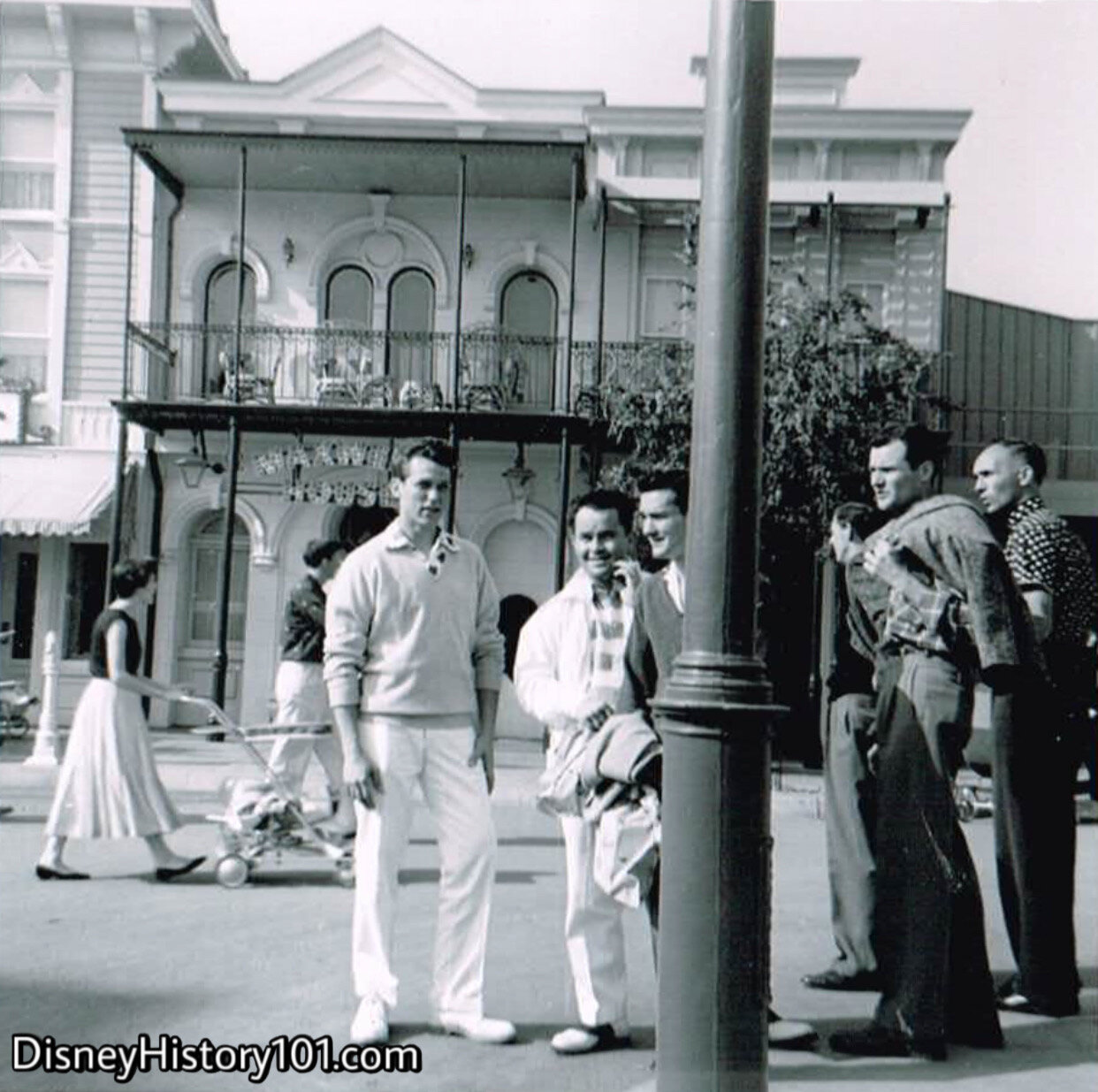
Now, Maxwell House Restaurant became the prime table-service restaurant of two Town Square locations where guests would to “tarry for a moment’s relaxation” before the rest of the Park opened in the morning, and enjoy a delicious cup of “good ‘til the last drop” Maxwell House Coffee (with superior flavor, aroma, and body)!
After setting foot inside the “turn-of-the-century hotel lobby, complete with an authentic registration desk,” guests “may choose a table in the starlight dining room, or be seated on the open-air patio,” according to “Food Showmanship Disney Style.”
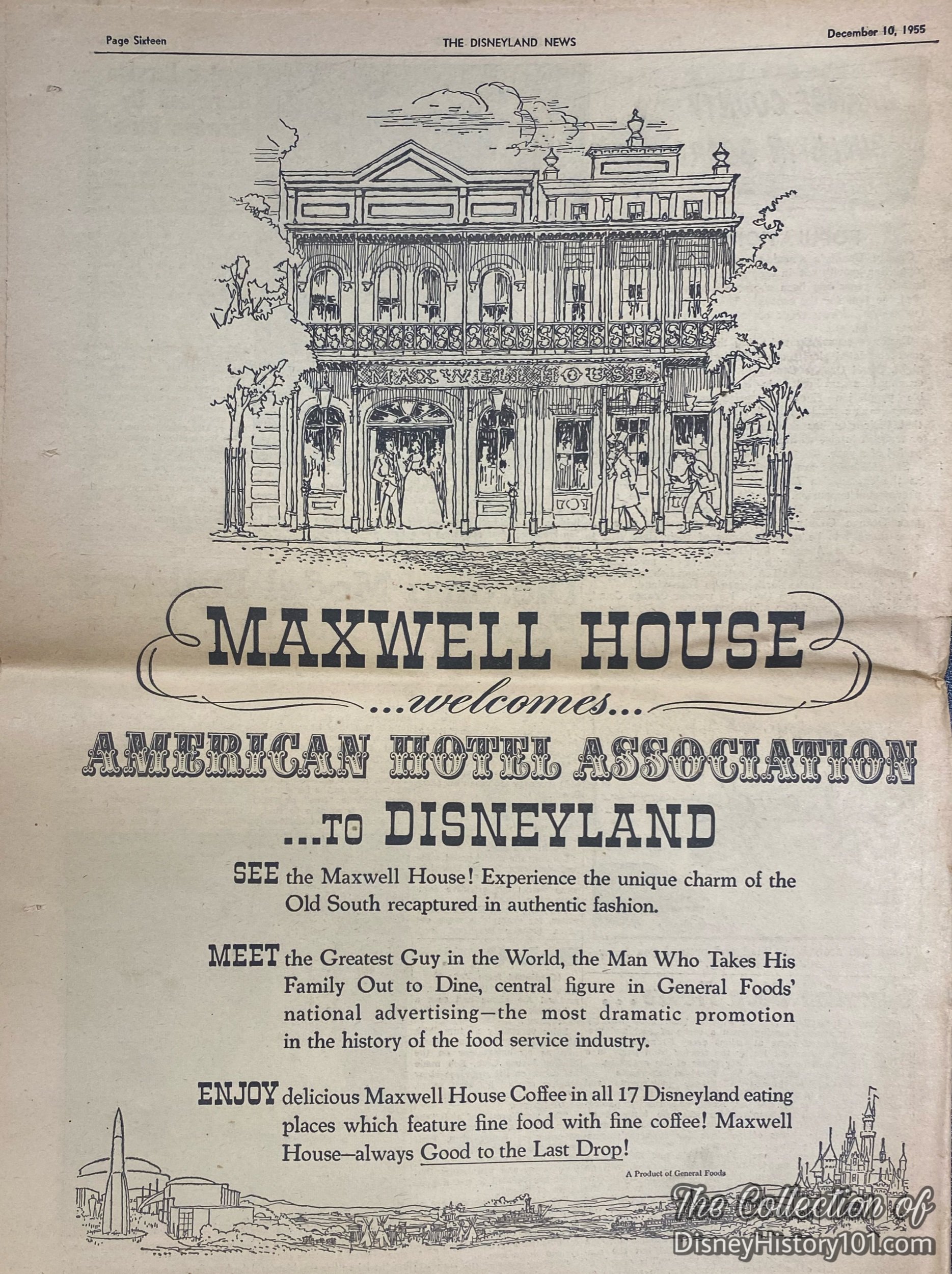
“The Greatest Guy In The World - The Man Who Takes His Family Out To Dine”
We are (of course) referring to another individual (in addition to Walt), who was key to the placement of the Disneyland lessee. The Maxwell Coffee House (as other restaurants and concessions) was strategically placed by Mister James D’Arcy. Owning to this, Ron D’Arcy would become part of the opening Maxwell House crew. Long before New Orleans Square, the decor of the Maxwell House represented “the New Orleans section of the ‘Old South’. Built to resemble a hotel of that time and place, it offers a jewel-like lobby sumptuously decorated with crystal chandeliers and velvet and plush furnishings. Past the lobby is the intimate coffee shop, serving coffee and pastries. Although indoors the coffee shop ceiling fades away to a midnight blue and stars twinkle above.” If some of the “railing and cresting (found here and other places on Main Street U.S.A. and Frontierland)” look authentic, its because some of them actually “came from old plantations in Nashville, Memphis, Tennessee, and some came from San Francisco, Oakland and Sacramento, California, dating back to the ‘49 days,” according to “News From Disneyland” (a Press Release document published c. 1956).
Maxwell Coffee House at Disneyland offered guests a variety of Maxwell House beverages including delicious Maxwell House Coffee, refreshing Maxwell House Iced Coffee, steaming Maxwell House Tea, refreshing Maxwell House Iced Tea, Baker’s rich Hot Cocoa, and Baker’s Ice Cold Chocolate Flavored Drink. Though the restaurant did not serve meals, it did carry a variety of light snacks (or, “Specialty items”) including Apple Sauce Cake, Homemade Danish pastry (served warm), Superb Cheese Cake (which paired well with a cup of Maxwell House Coffee), Old Fashioned Strawberry Short Cake, Assorted French Pastries, Hot Fudge Ice Cream Cake, and a fancy Jell-O gelatin dessert topped with whipped cream!
On December 10, 1956, George Banning, distributor of Maxwell House coffee provided beverages for the First Annual Christmas Party.
Both Walt Disney and those who held his business ethics, principles, and standards for Disneyland, made sure that the price of coffee was always economical and reasonable. Walt assured that coffee was “only worth a dime.” This was true during Maxwell’s participation and during participation of the following sponsor. After Walt’s passing, “Card Walker, Vice President of advertising and sales, further insisted, ‘Disneyland will always have a ten-cent cup of coffee.’ It wasn’t until after Walt’s passing in 1966 that the price increased,” according to “Eat Like Walt - The Wonderful World of Disney Food” by Marcy Smothers.
The corporate synergy was good for a time. Institutional lessee Maxwell House Coffee yielded some revenue for Disneyland Inc. - $28,599 for the fiscal year ending September 29, 1957 and $79 for the remainder of its occupation during the fiscal year ending September 28, 1958. The synergy was also beneficial for both. For instance, when the Disneyland Recreational Club and Athletic Coordinator Frank Smith sponsored a new Gun Club, Maxwell House Coffee Shop hosted Disneylanders attending the first meeting on January 10, 1958.
Future additions to Maxwell were soon planned for Building 600, which would have included a large room and an office.
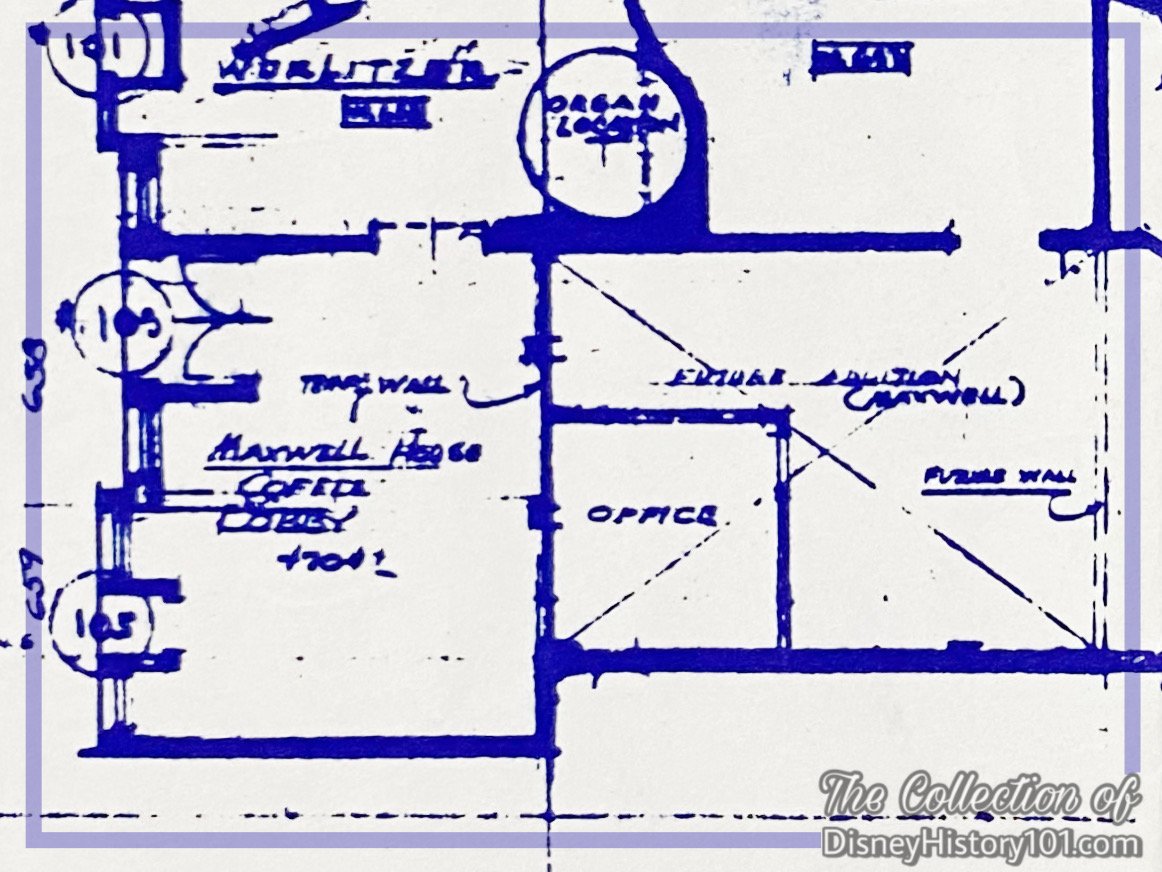
However (by September 28, 1958), Disneyland Participant Affairs (or, “Industry Sales”) and Maxwell House could not negotiate a cooperative agreement to maintain their ongoing relationship. So Maxwell House would depart from Disneyland at a lease termination expense of $34,730.
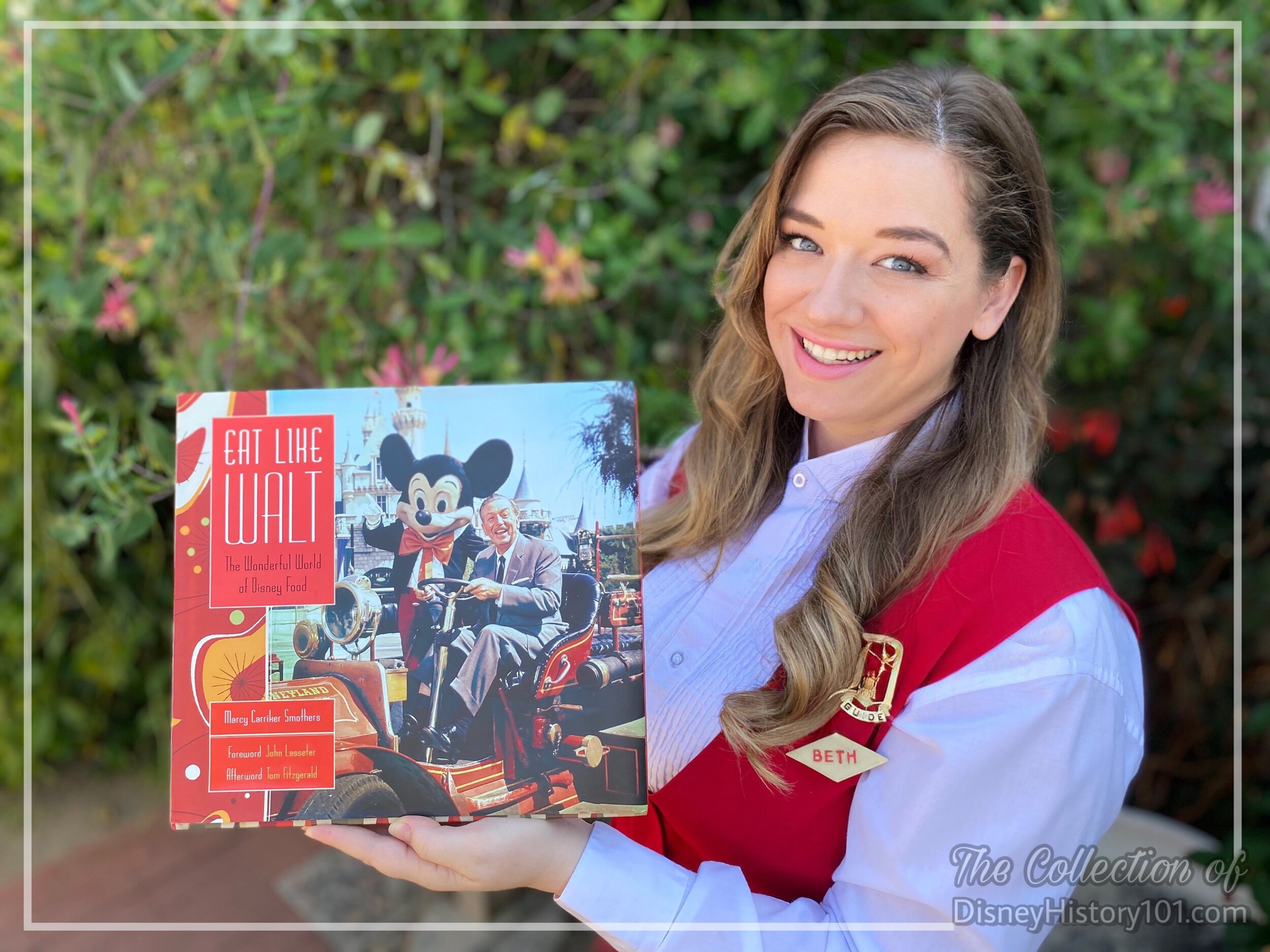
If you would like to read more about Maxwell Coffee House, it’s my pleasure to recommend adding Marcy Smothers’ “Eat Like Walt - The Wonderful World of Disney Food” to your personal Disney Home Library! If you would like to bring the magic of Disneyland restaurants and concessions to your dining room table, “please step this way” toward www.eatlikewalt.com where Marcy has shared a few recipes for memorable Disneyland menu options, including that of the Santa Fe Express Sundae, so that you too, can “Eat Like Walt!”

A number of Disneyland Participants sweetened the coffee of guests through the years! When Disneyland first opened in 1955, the “extra-fluffy and silky-soft” powdered sugar of Spreckels Sugar Company (of San Francisco, California) was the exclusive sugar of Disneyland. Creamy frostings were whipped up using Spreckels and guests dining at the Hills Bros. Coffee House would often sweeten their coffee with Spreckels sugar cubes and Spreckles sugar packets. Advertisements for Spreckels Sugar even ran in the earliest issues of “The Disneyland News.”

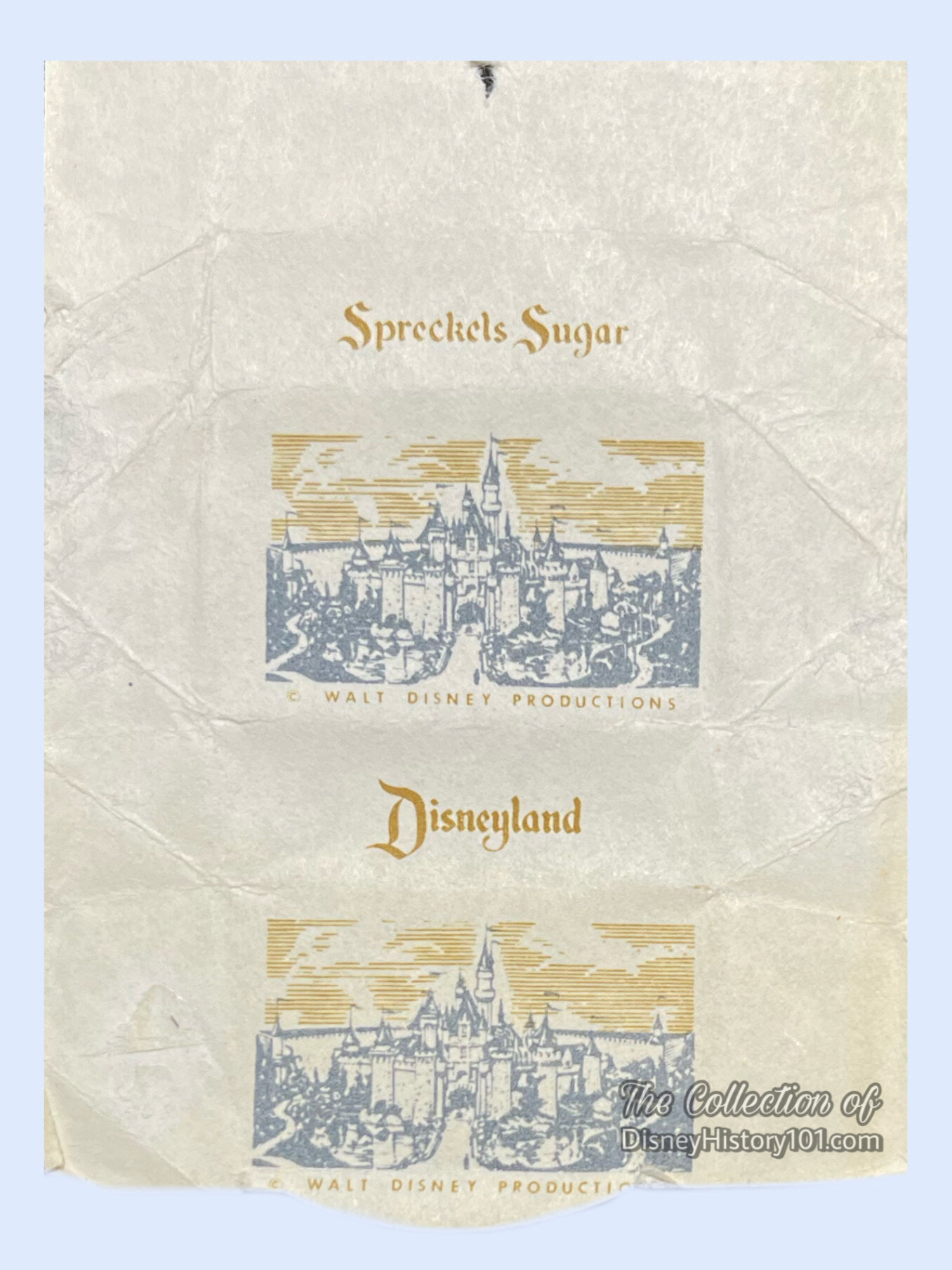
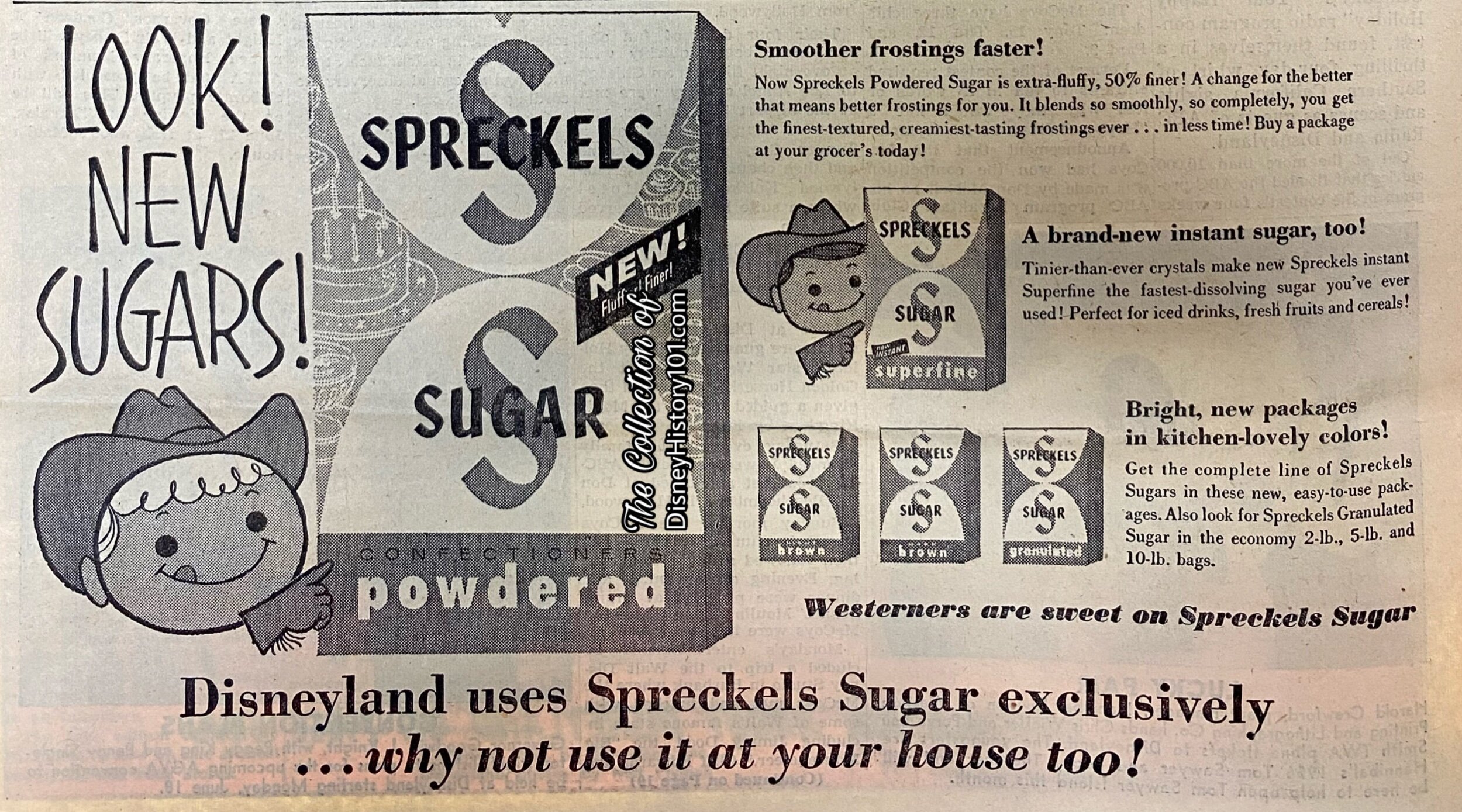
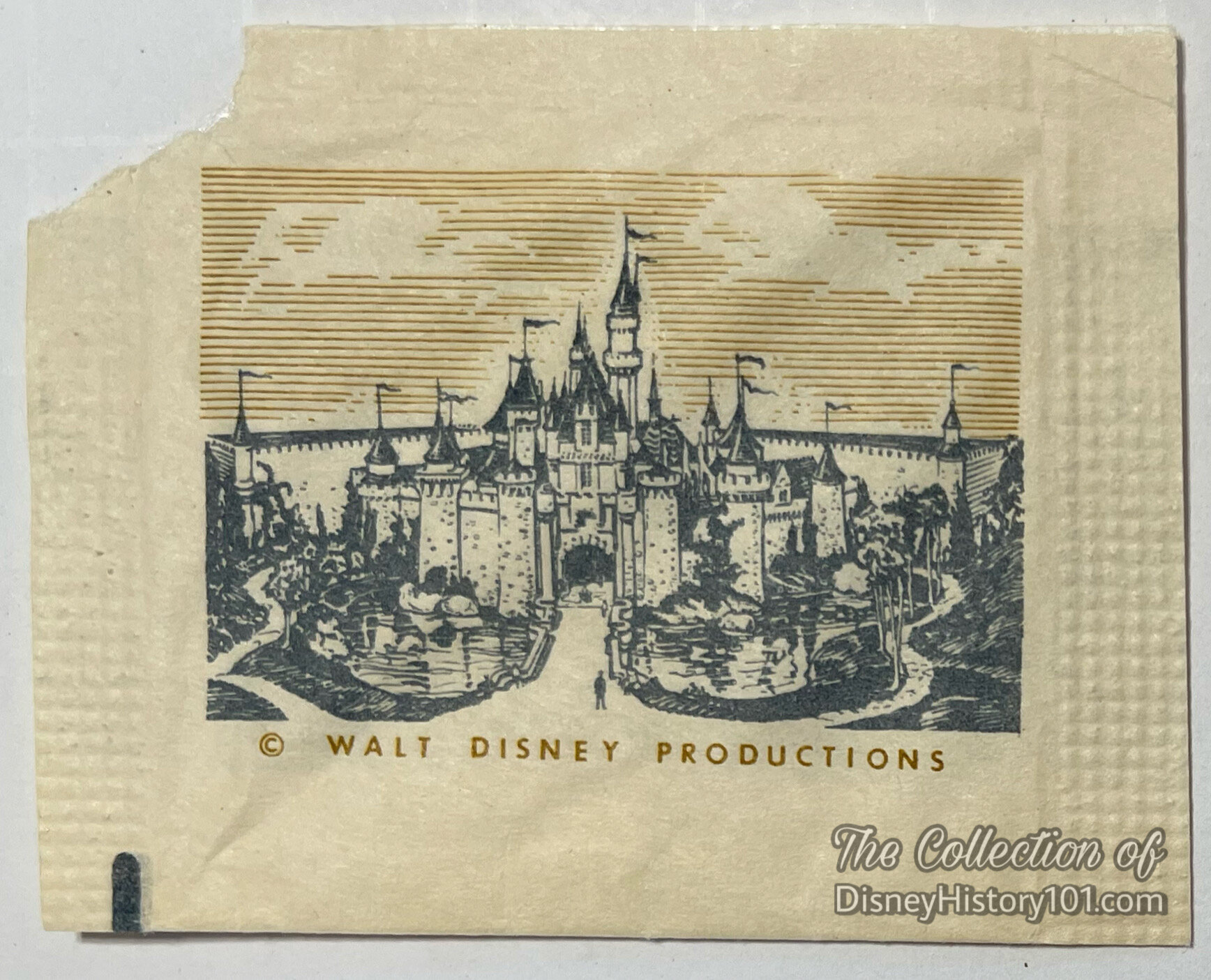
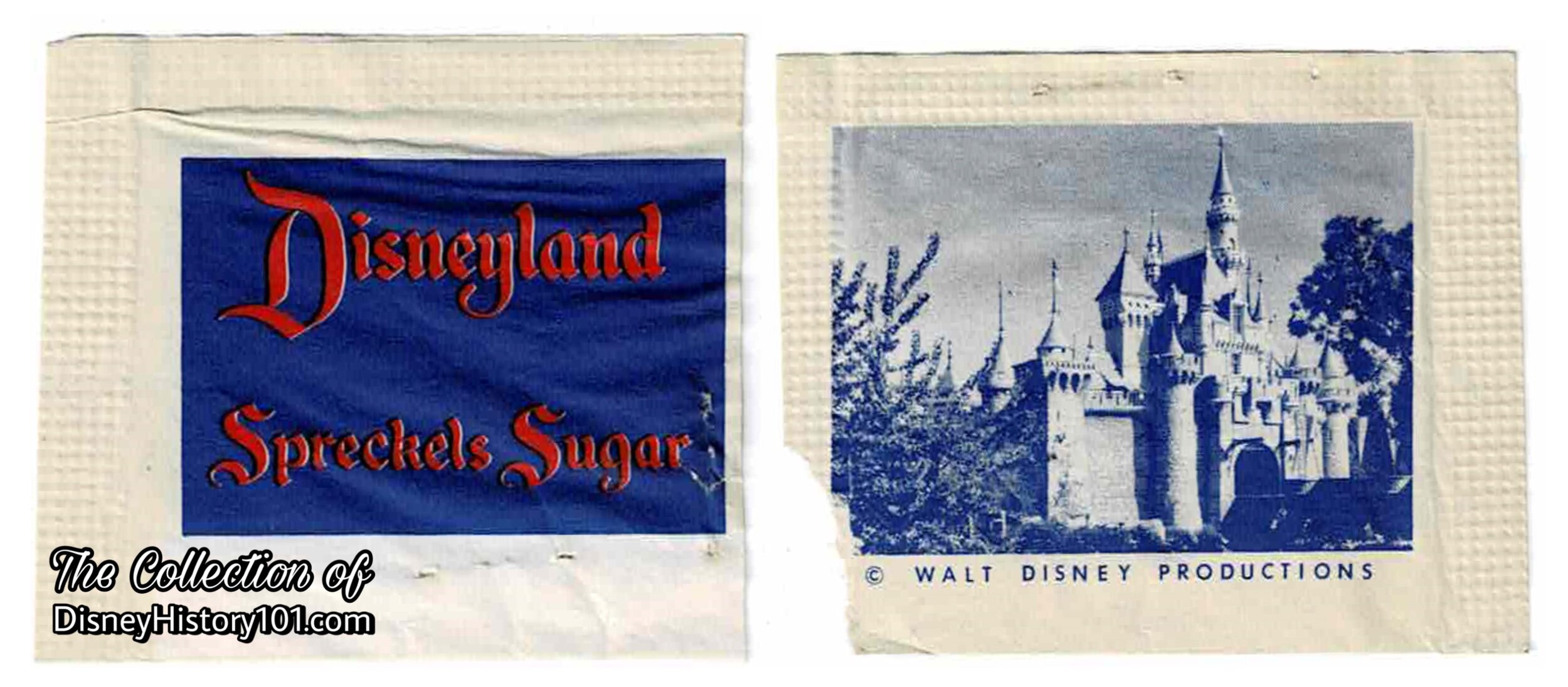
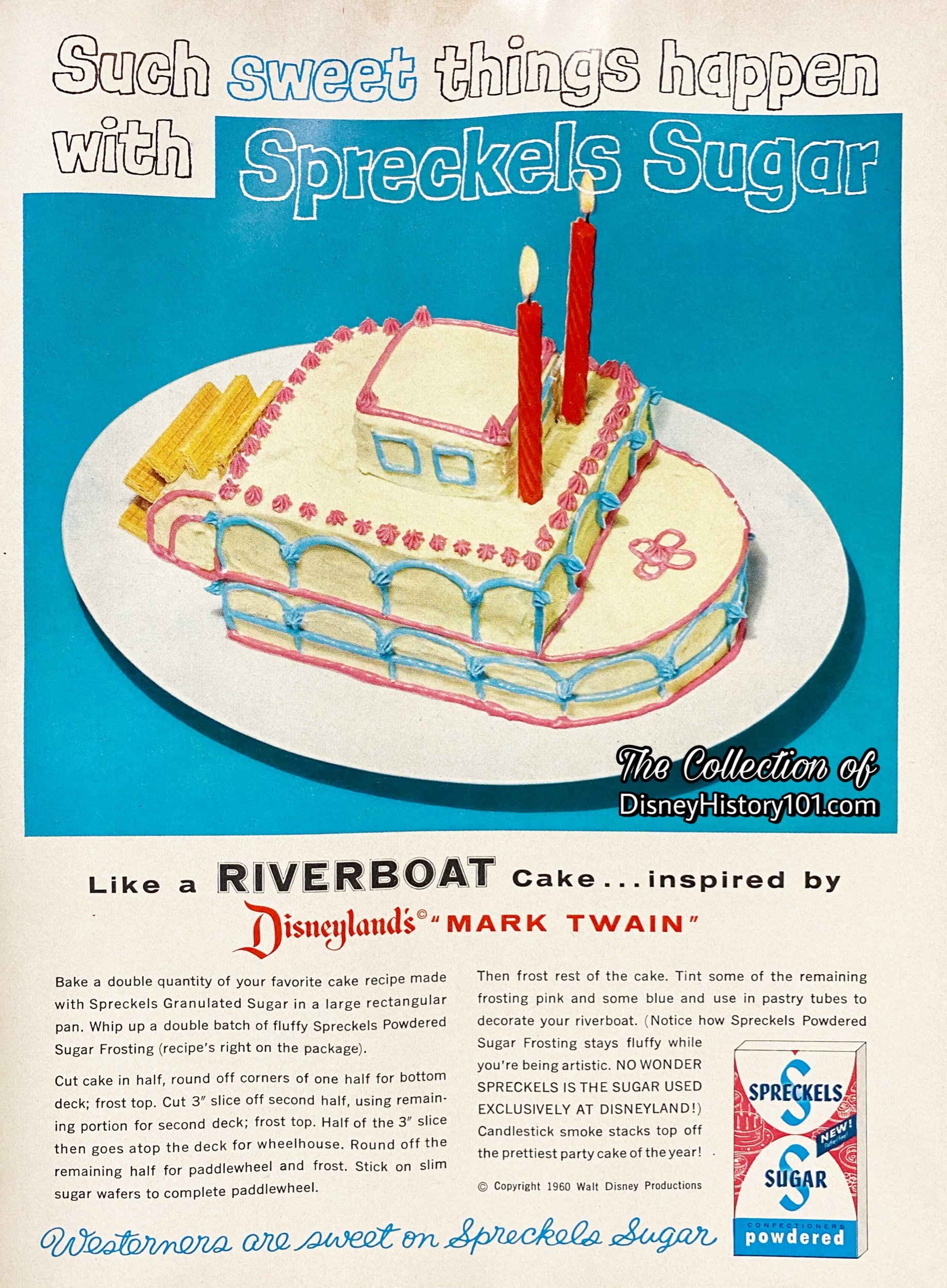
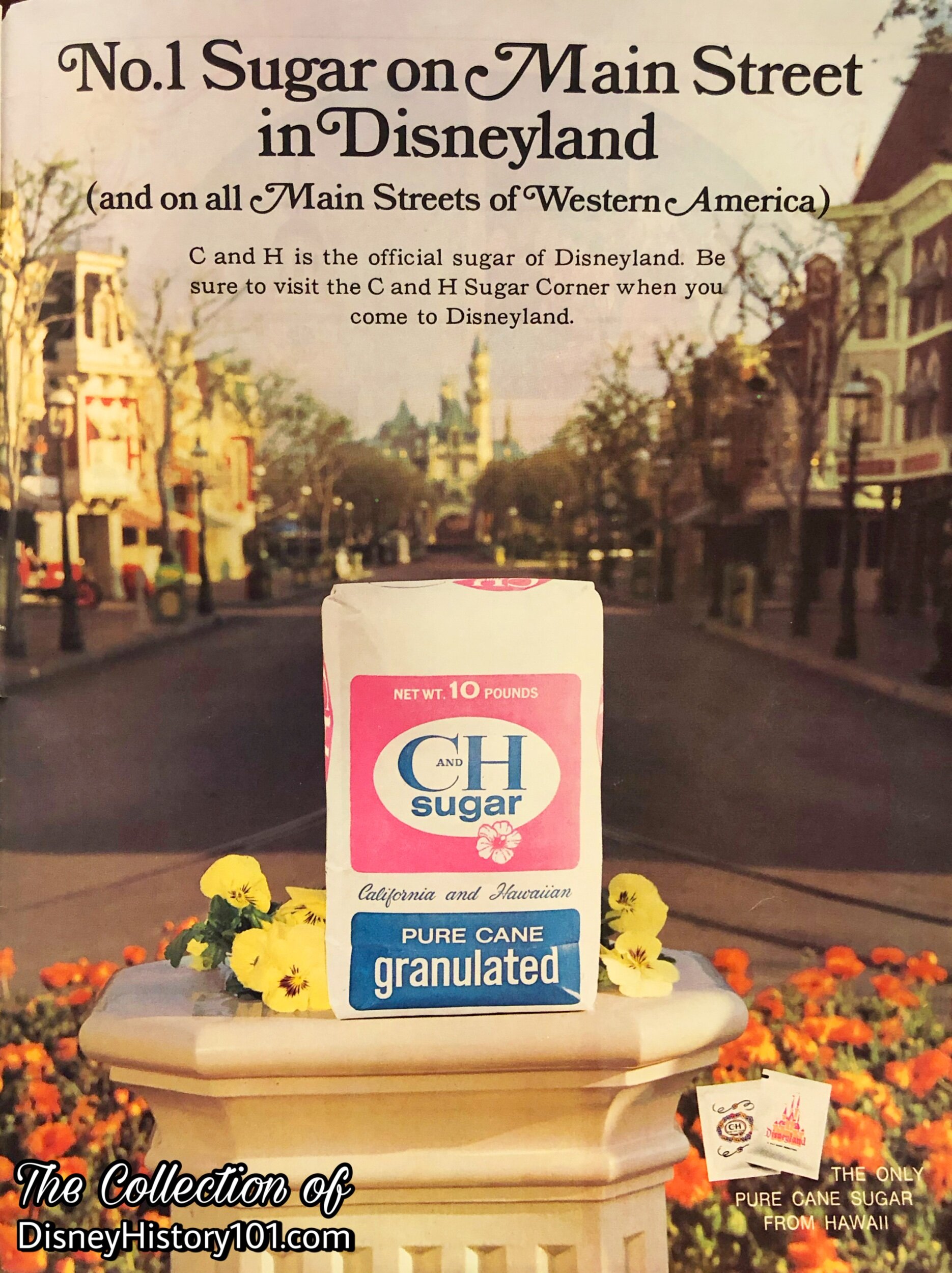
By 1972, Dixie Crystals became the official sugar of the Magic Kingdom and Walt Disney World. Soon, there was another “No. 1 Sugar on Main Street in Disneyland” - C and H Pure Cane Sugar from Hawaii. C&H became the official sugar of Walt Disney’s Magic Kingdom, in 1962! Still other sugar brands (like Domino Sugar) could be found contemporaneously at Wrather Corporation’s Disneyland Hotel.
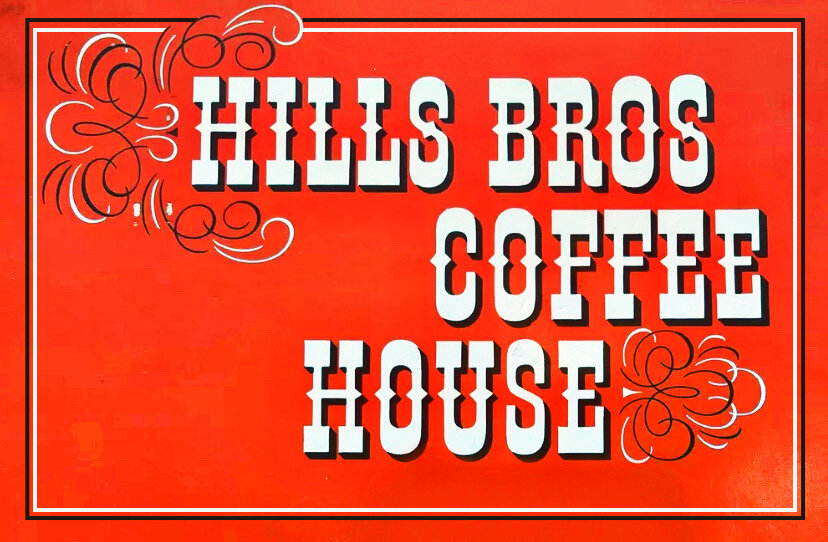
The corporate synergy was “good ‘til the last drop,” until (after less than two years) Participant sponsor Maxwell Coffee departed from Disneyland. After a brief period of vacancy (at least by January 1, 1958), Hills Bros. Coffee stepped in to sponsor the 1,340 square-foot space and additional 180 square-foot kitchen. The remaining Maxwell Coffee House interiors were sold to Hills Bros. at a cost of $27,500.
Only now (by 1958-1959), the leaseholder - Hills Bros. - made an improvement. Disneyland Inc. opened Hills Bros. Patio Job #032-50-26 for the construction of an addition to the Kitchen and dishwashing area of the building and an open patio adjoining Hills Bros. premises on the East side of building and facing Town Square.
Preliminary Designs were created by the Studio at the cost of $1,549.47, and working drawings were created (by the studio at $390.65; by another party at $438.88). Curtains, shades, awnings & canopy were fabricated at a cost of $301.27. Including the Studio EB (part before direct distribution), Studio overhead @ 25%, Studio charges, Construction Overhead, Subcontracts (in the IBM job file), total costs for Job #032-50-26 totaled $26,144.47. After a portion of the job was billed to Hills Bros., the cost was $4,255.00, with a $21,889.47 net to capital.
The additions of enlarging both the kitchen and dish-washing areas were later appraised at $4,000. An 8’x12’ women’s dressing room (Job #032-50-50; constructed at $1,248.02) was also attached to the Hills Brothers storeroom in the service area.
Before long, “a taste of San Francisco” arrived with the Hills Brothers Coffee Shop and Coffee Garden operated by Food Service, Inc. The interior of the restaurant was still decorated in a “southern garden motif with an adjacent dining patio,” according to the “Disneyland Dictionary” (compiled by WED Enterprises, Inc. and WED Public Relations Department, c. 1968).
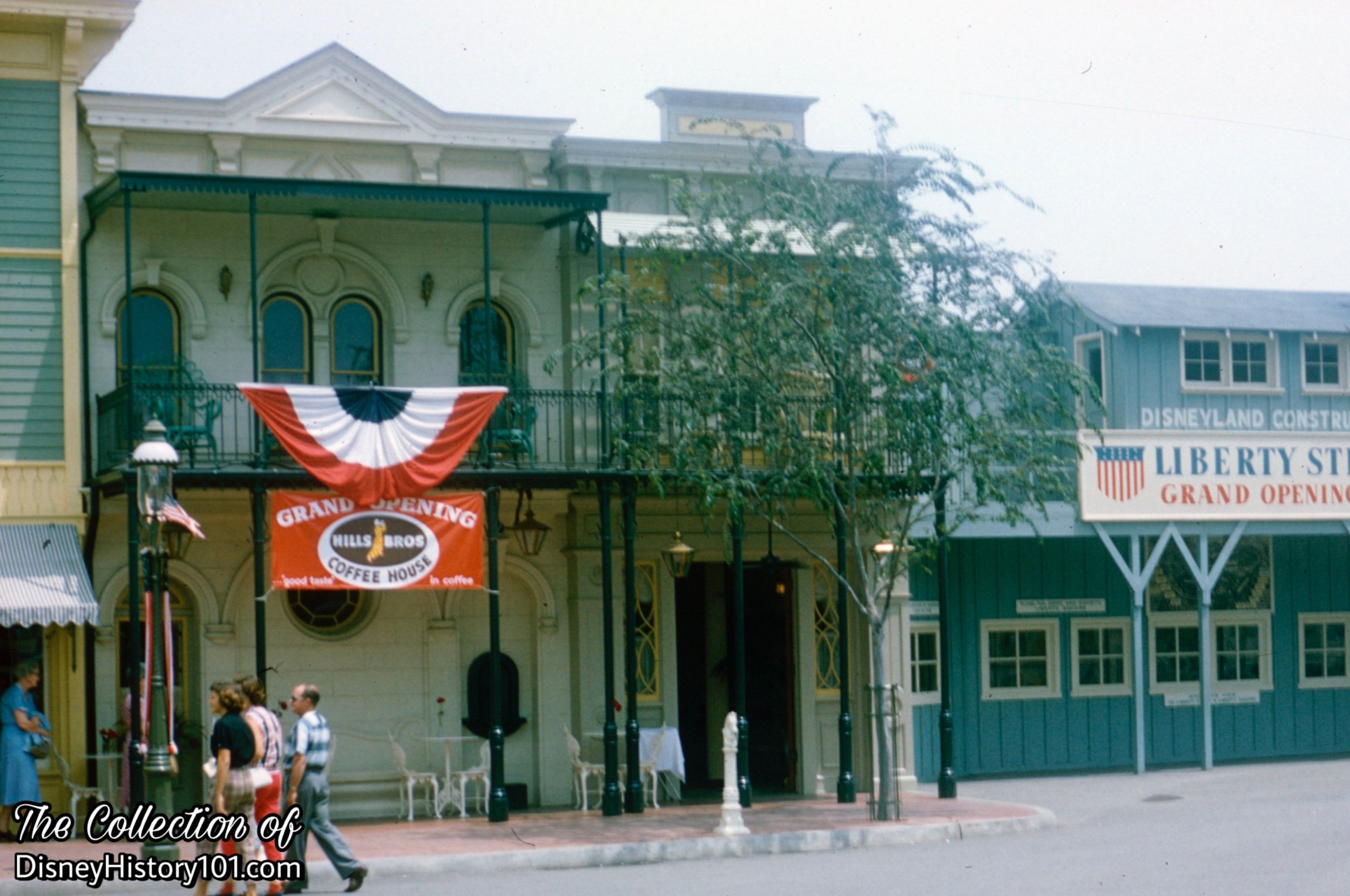
Guests were soon welcomed “to the garden of ‘Ahh!’” Hills Bros. remained the sponsor of the Hills Bros. Coffee Garden for almost twenty memorable years! During this time, the Hills Bros. Coffee Garden offered waitress service, with a maximum guest capacity of 125.

After the Park closed, the staff would take over with brooms, mops and dustcloths. Special attention was given to marred walls, posts and furniture. Items with marks that didn’t wash off were replaced or repainted. Floors were waxed and buffed to preserve their beauty and protect them from the thousands of feet that scuffled over them each day.
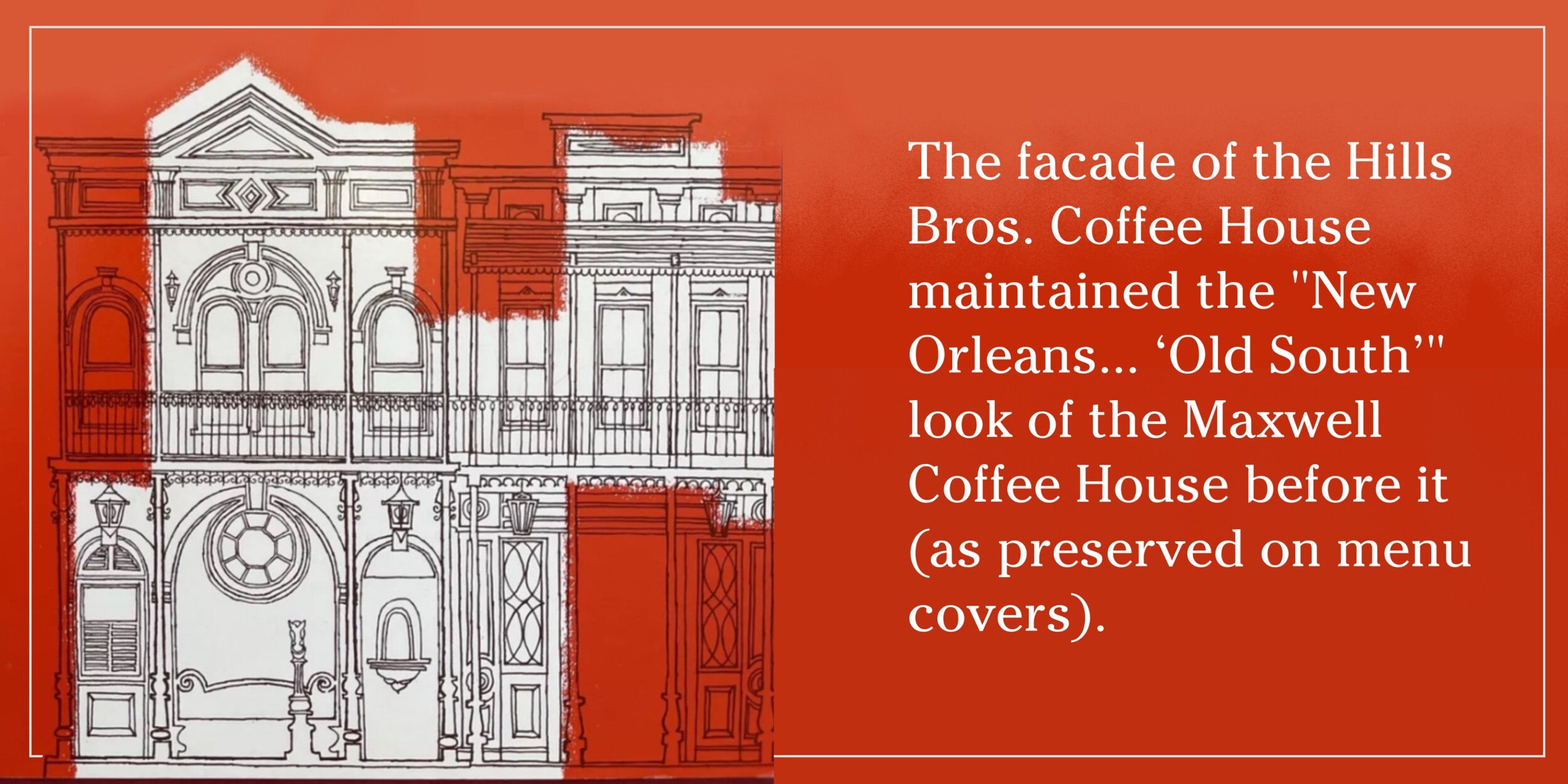

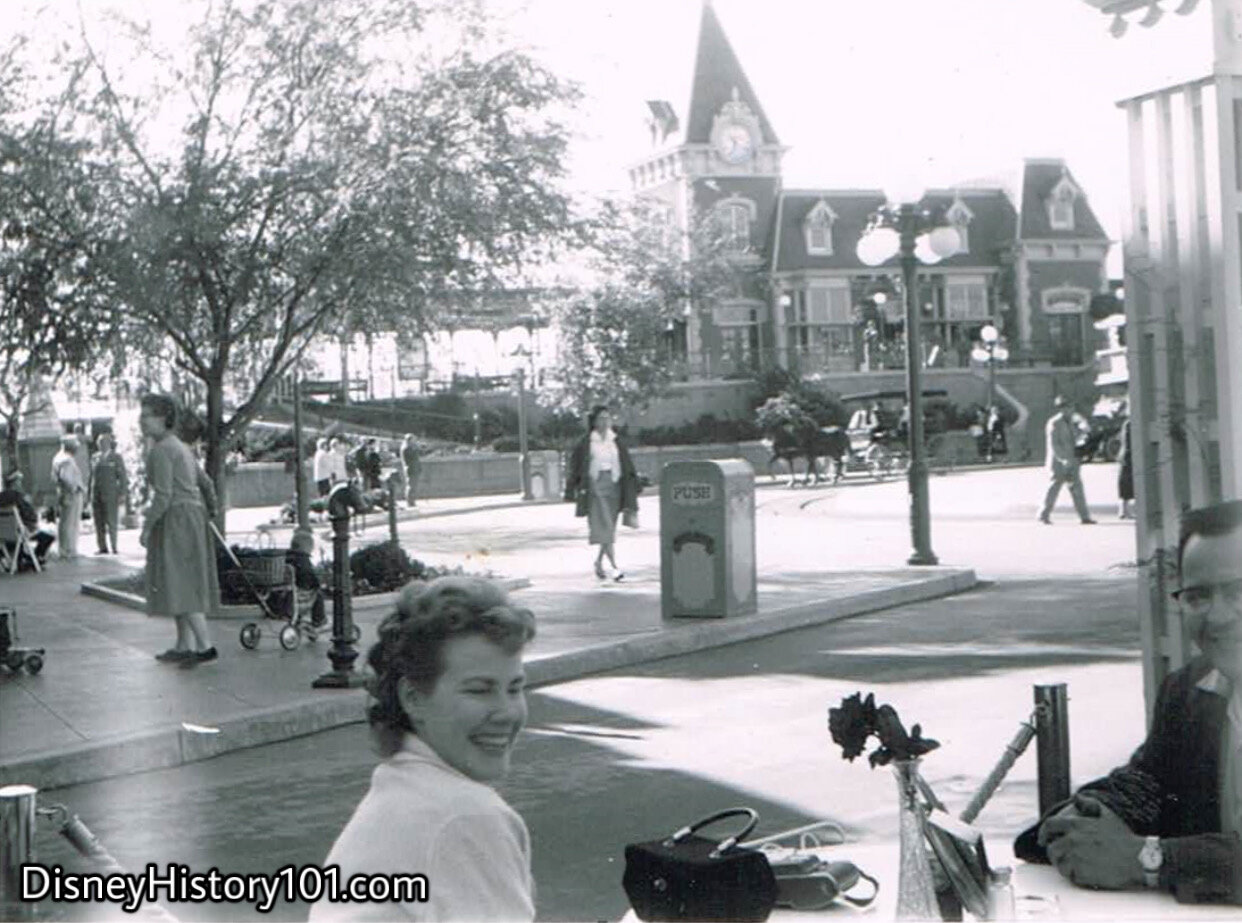
These guests prefer to brighten their “morning with a cup of delicious Hills Bros. Coffee!” The Town Square tradition of enjoying a cup of coffee in the garden continues as guests were invited to start their morning with a refreshing cup of Hills Bros. Coffee.
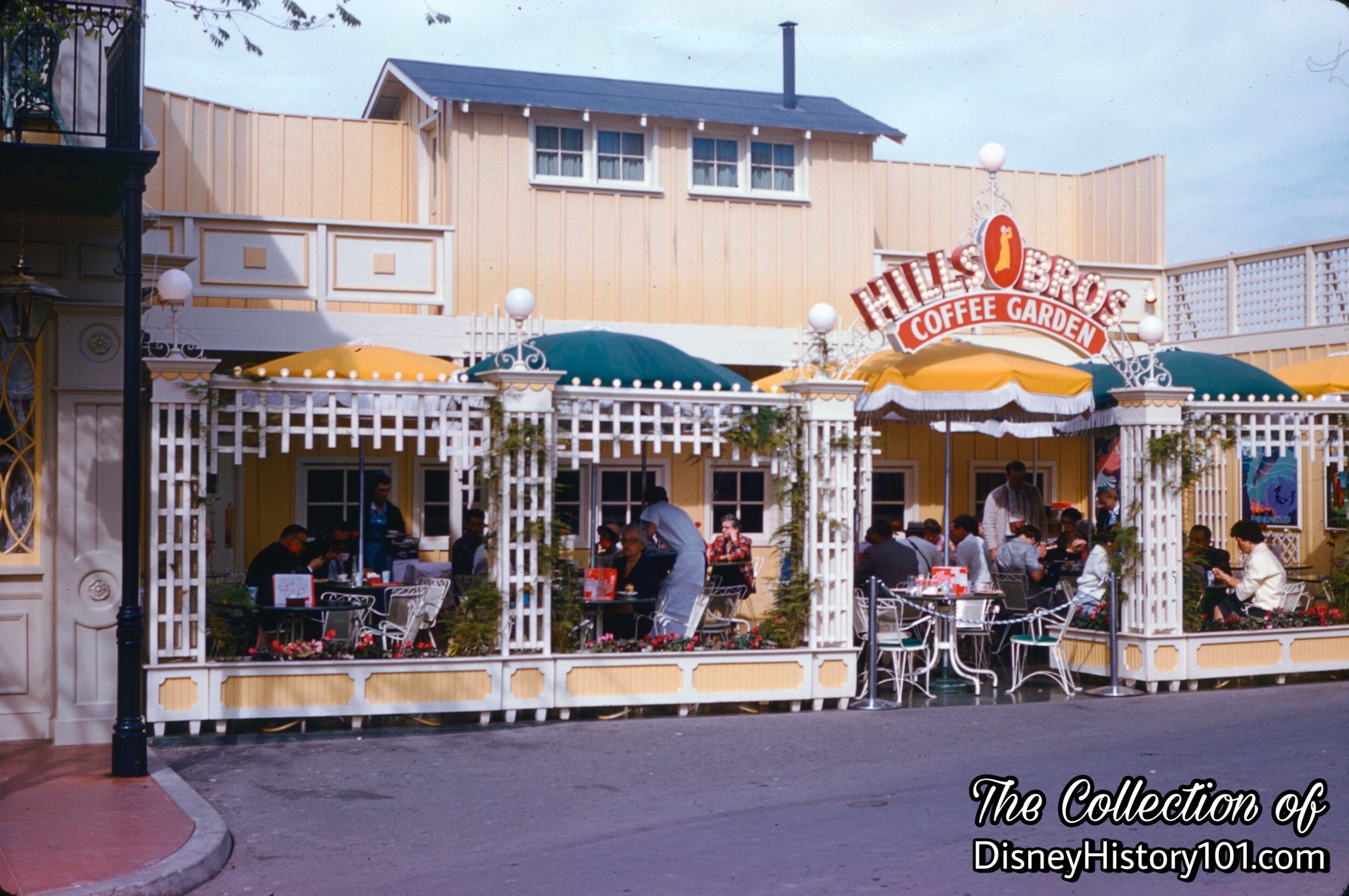

Disneyland visitors are welcome to relax with a Hills Bros. Coffee prepared either piping hot or icy cold. Youngsters can also recharge with nourishing drinks. Where the Maxwell Coffee House offered light snacks, Hills Bros. Coffee Garden offered meal items. According to one Disneyland Guide, guests could now “pause to enjoy freshly-made sandwiches and a variety of delectable desserts and beverages” at Hills Bros. Coffee Garden. Yes, in addition to beverages, doughnuts, breakfasts, and sandwiches were offered.
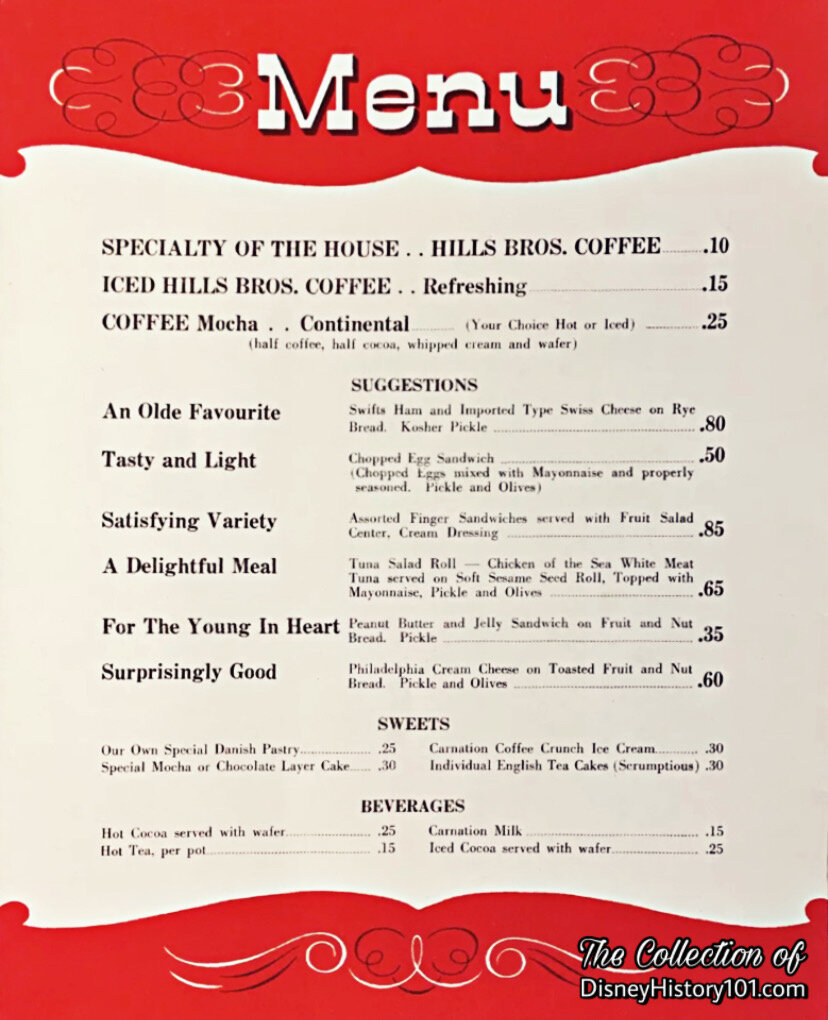
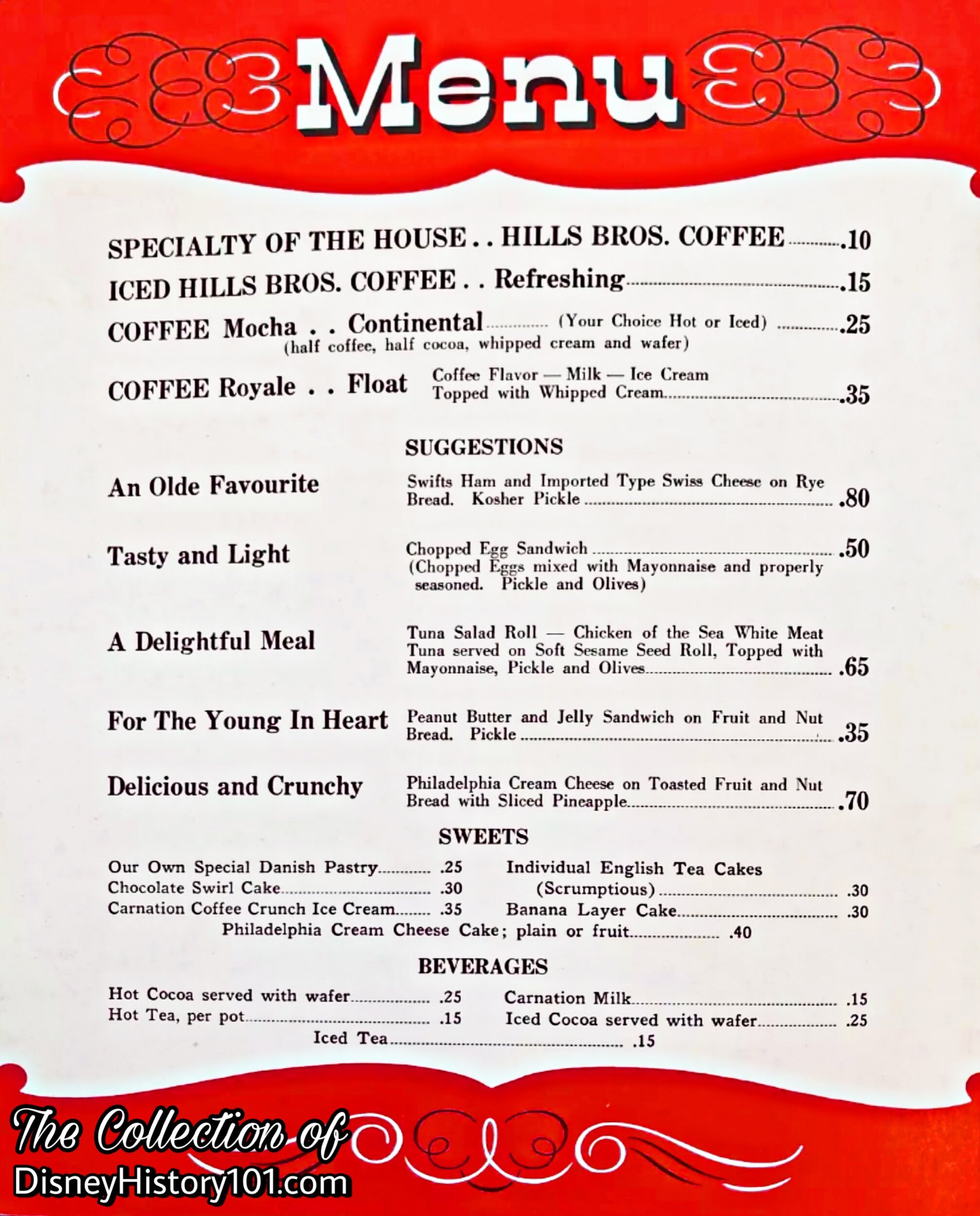
The option described as the “Delicious and Crunchy” suggestion was (on other menus) also referred to as the “Surprisingly Good” sandwich! But this sandwich was in like most - toasted fruit on a nut bread, with a Philadelphia Cream Cheese spread.
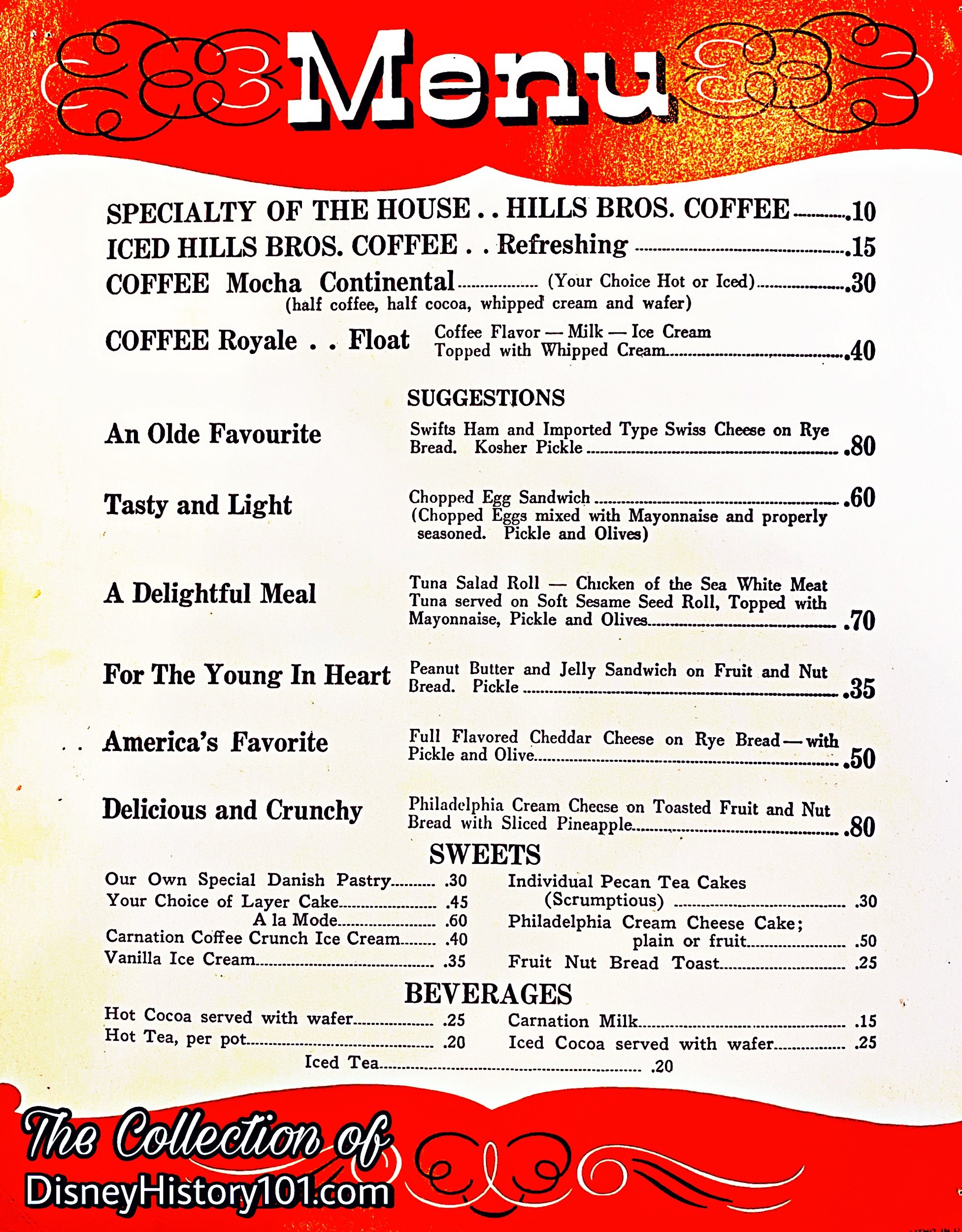
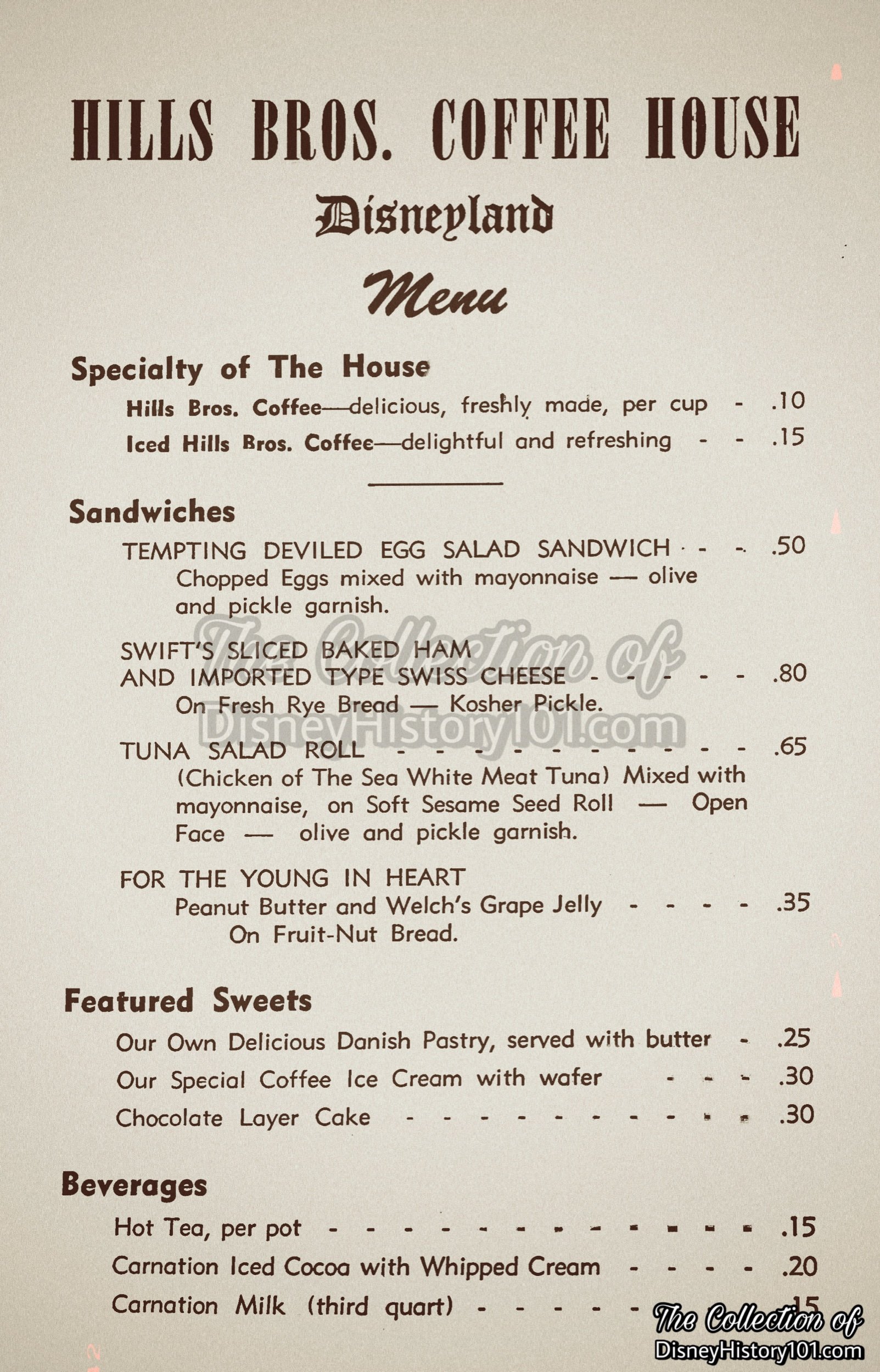
If all these delicious options weren’t enough, guests could also schedule direct reservations for dining at the Disneyland Hotel Gourmet Restaurant and Coffee Shop from the Hills Bros. Coffee House.
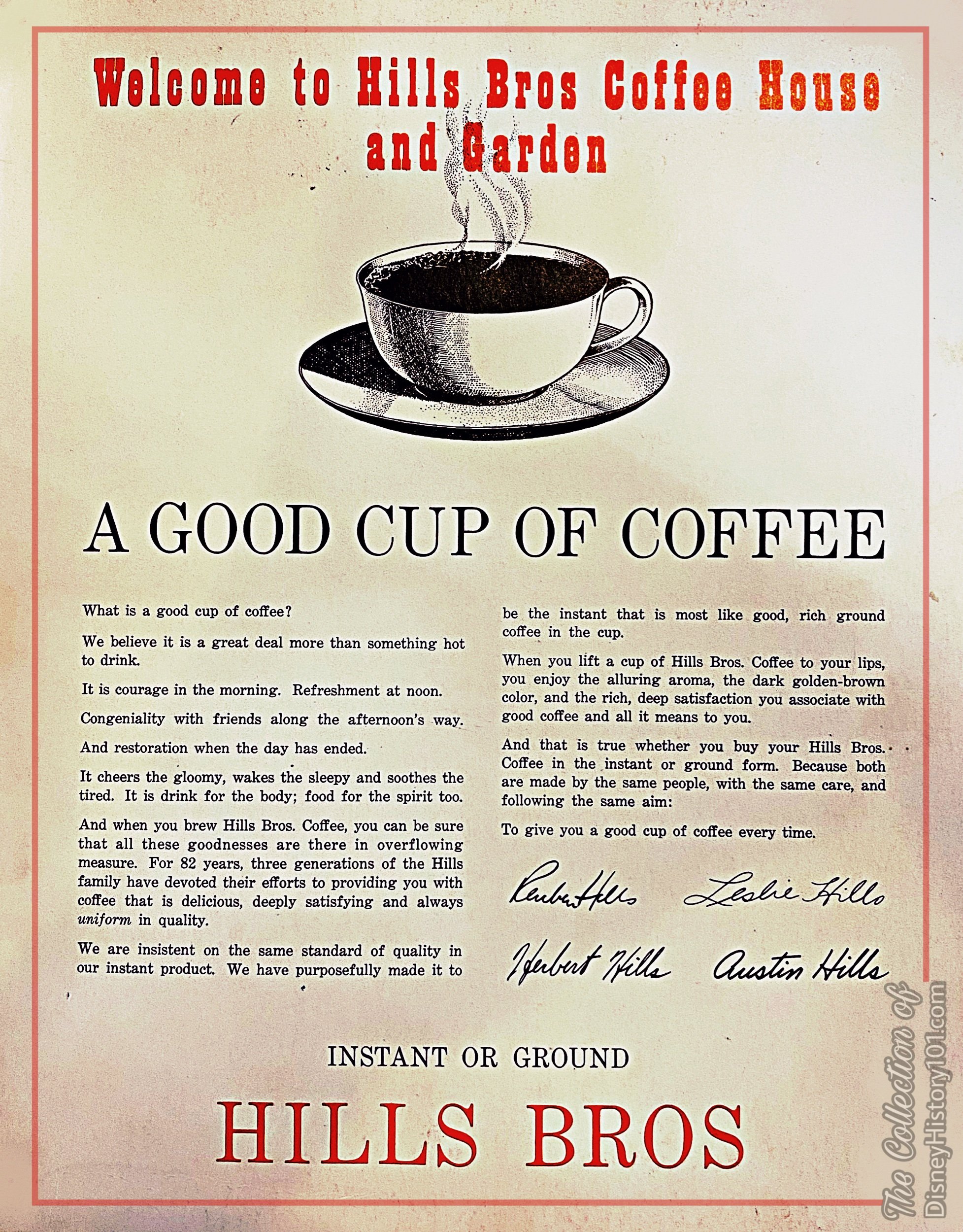
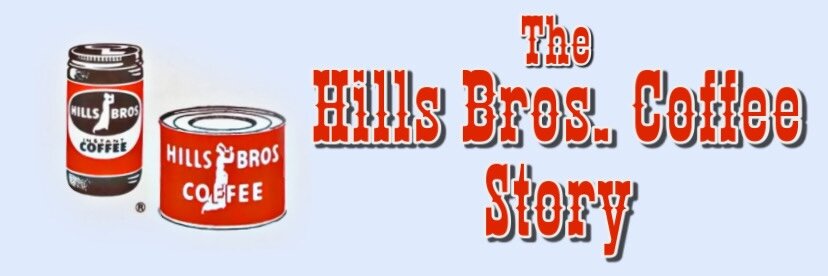
While relaxing with a cup of Hills Bros. Coffee, guests could pick up a menu and read the success story of Austin H. and Rubin W. Hill, as well as their innovations - “Instant Coffee” and vacuum-packaged coffee beans!
The corporate synergy was good for a time. Institutional lessee Hills Bros. Coffee, Inc. yielded some revenue for Disneyland Inc. - $9,626 for the fiscal year ending September 28, 1958.
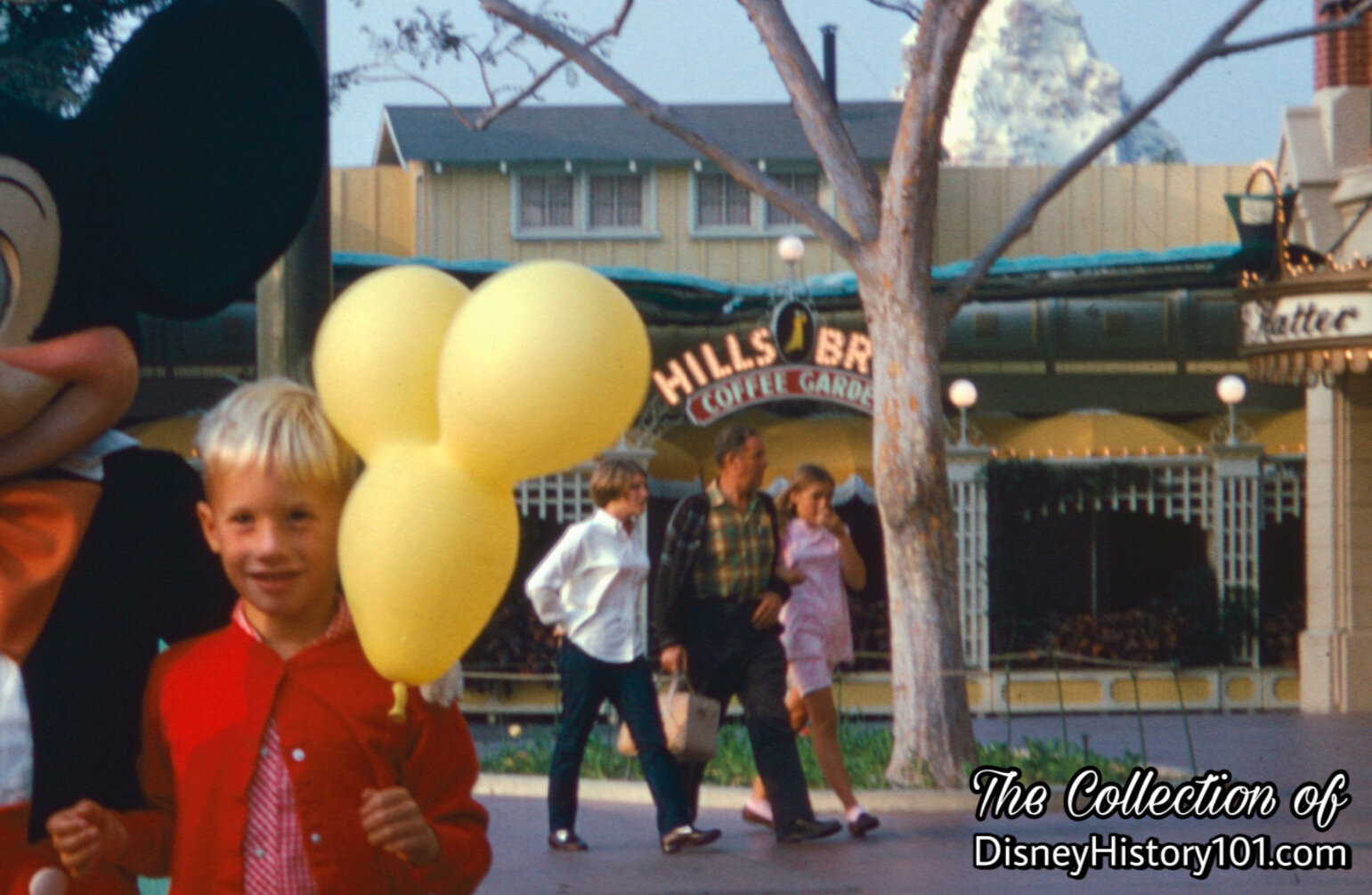
Not far from where Mickey Mouse greeted guests, the Disneyland Christmas Carolers (under the direction of Dr. Charles C. Hirt and lead by Mr. Robert G. Hasty), also known to perform near “Hills Bros.” during various times of the day, from December 16th, 1967 thru January 1st, 1968. [“Disneyland Holiday Talent Master Schedule,” prepared for the period of December 16, 1967 through January 1, 1968]
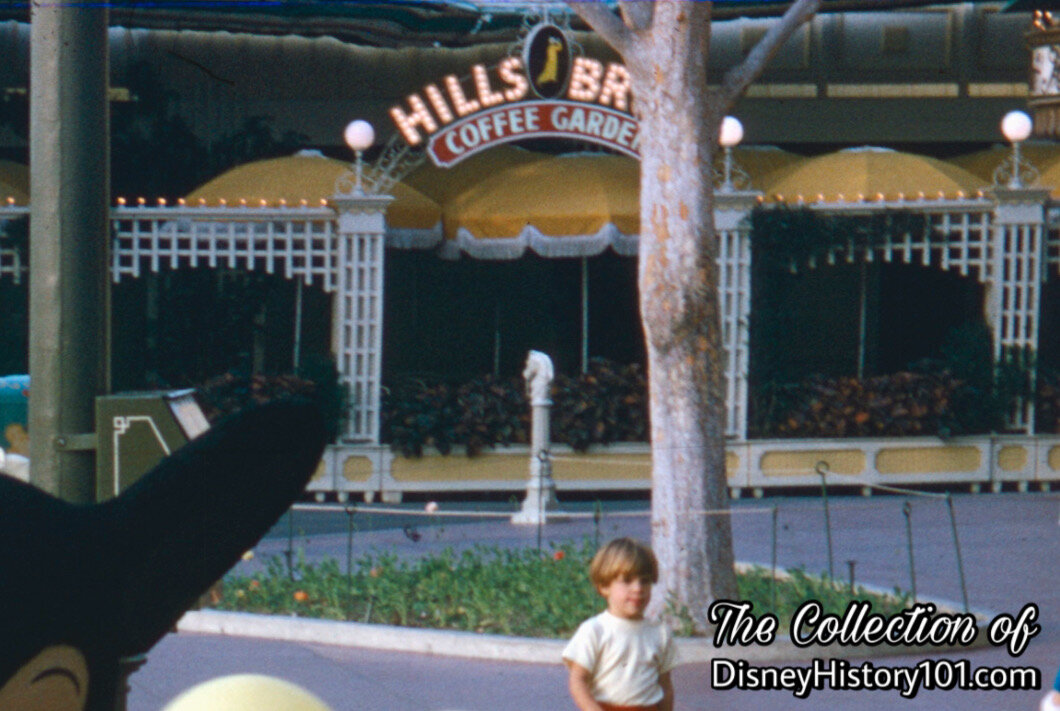
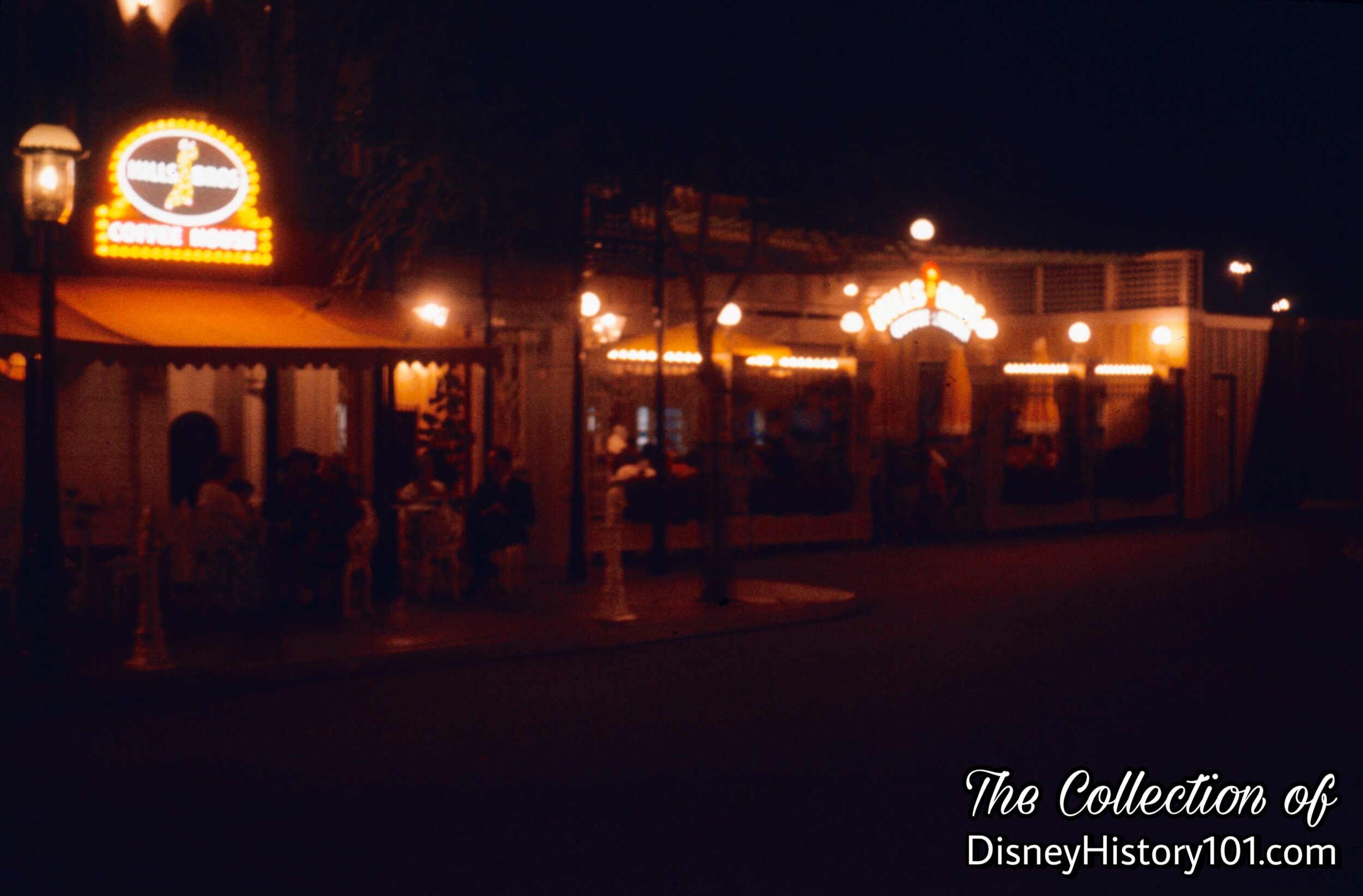
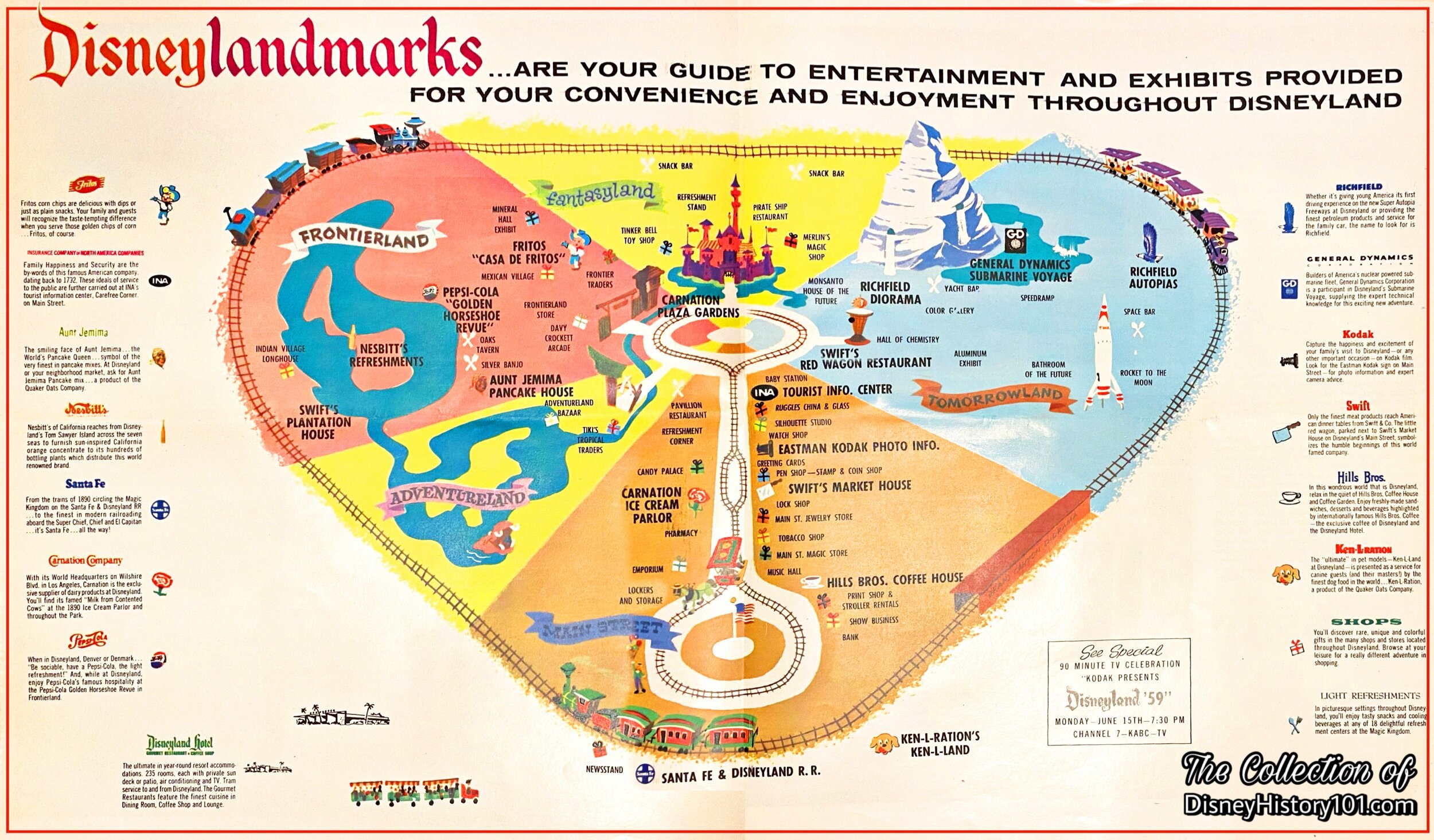
The first Disneyland Dictionary (printed in October of 1959) noted “Hills Brothers Coffee Shop and Coffee Garden operated by Food Service, Inc.” served “Hills Brothers' Coffee and light refreshments.” Owning to Jack Sayers (of Lessee Relations), Hills Bros. Coffee was a proud and contributing sponsor of “Disneyland ‘59”! In fact by October of 1959, Hills Bros. was (1) of over sixty-eight other firms playing a vital part in the team effort to bring happiness to Disneyland’s Guests. Some were small, specialized individual operators; some were huge companies such as Swift & Co. - the Bank of America - United Paramount Theaters (which you hear as UPT) - Carnation - Richfield - General Dynamics - Crane - and many others. These companies used the park to publicize their wares, leased space in the Park to sell their wares, and Disneyland collected advertising fees from them.
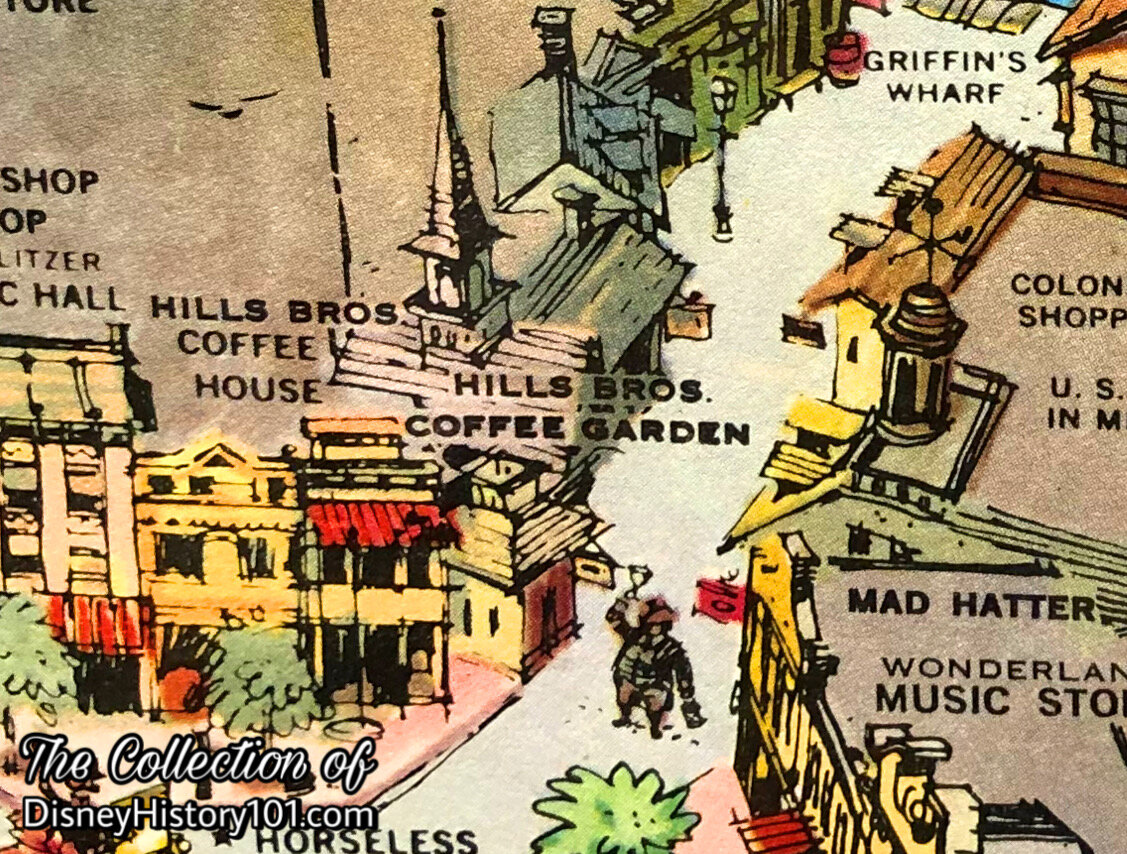
The Hills Bros. Coffee House would have stood at the gateway to the planned “Future Attraction” of Liberty Square.
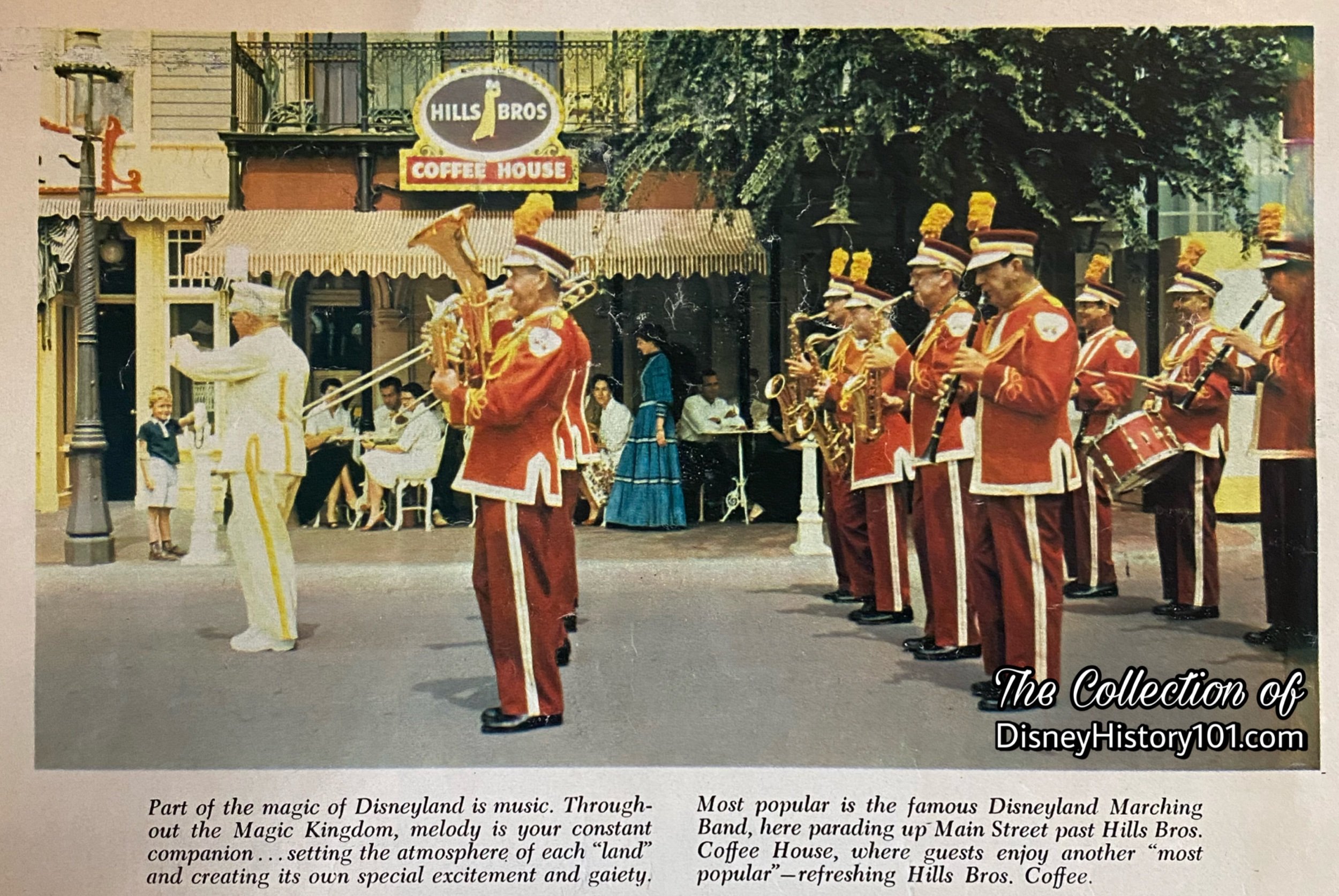
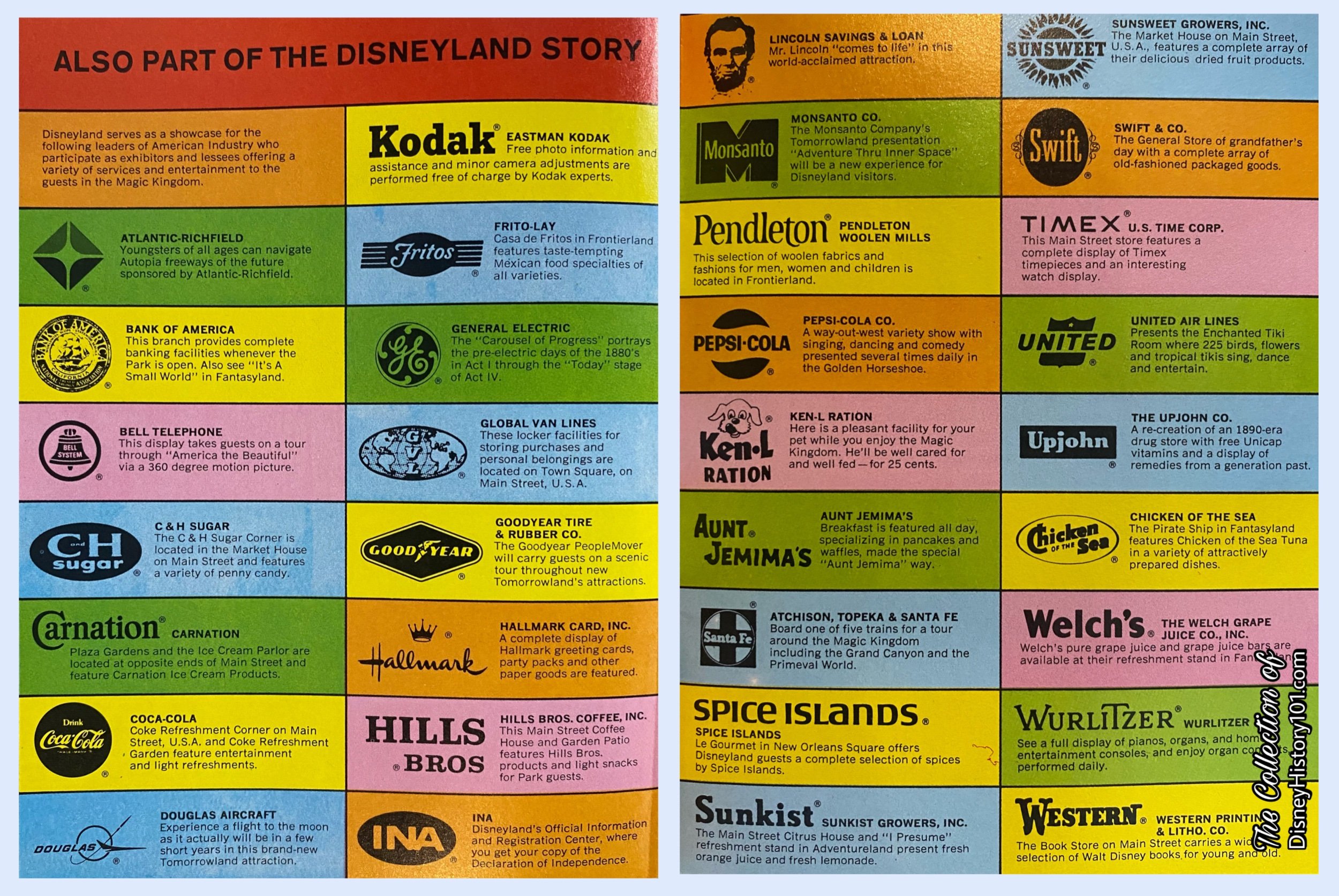
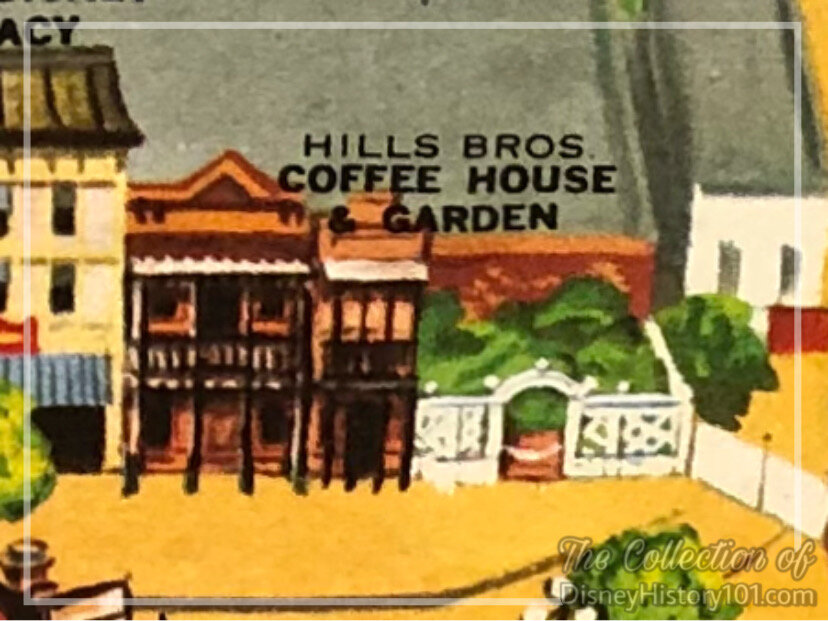
Sponsored by Hills Bros. Coffee Co., Hills Brothers Coffee House and Restaurant featured famous Hills Bros. coffee. The restaurant also offered tempting sandwiches and desserts within an interior that was in a southern garden motif with an adjacent dining patio.
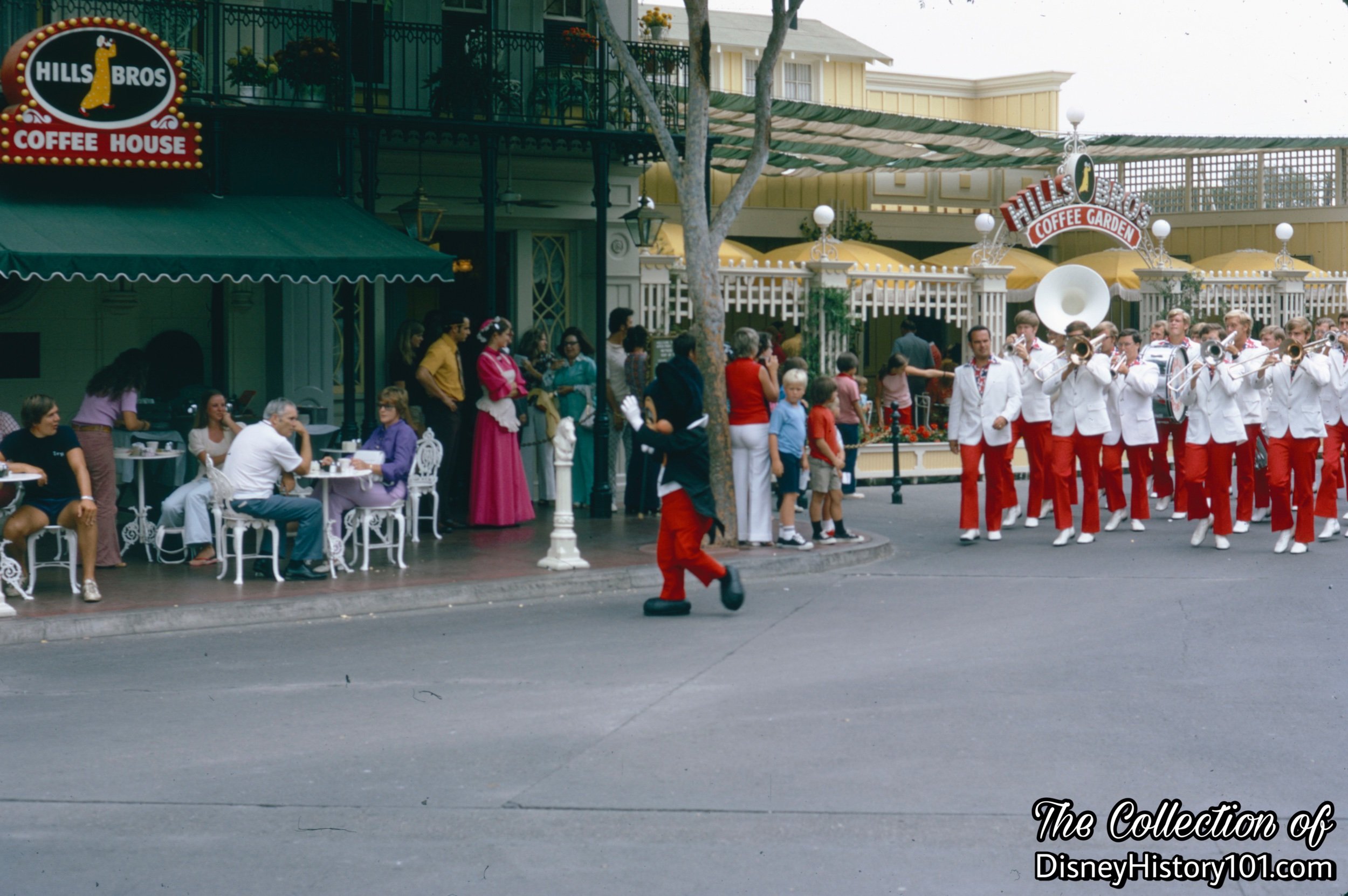
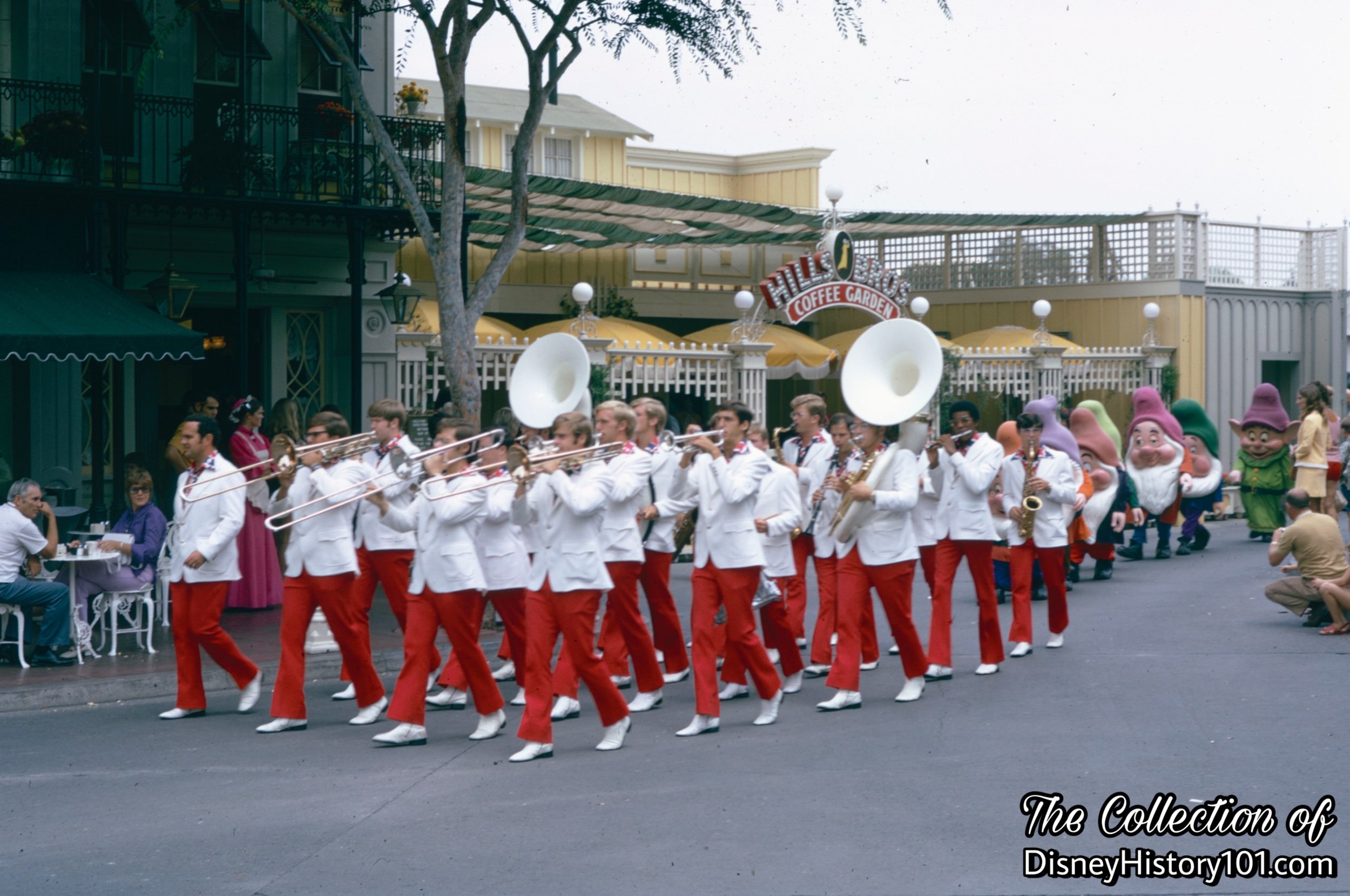

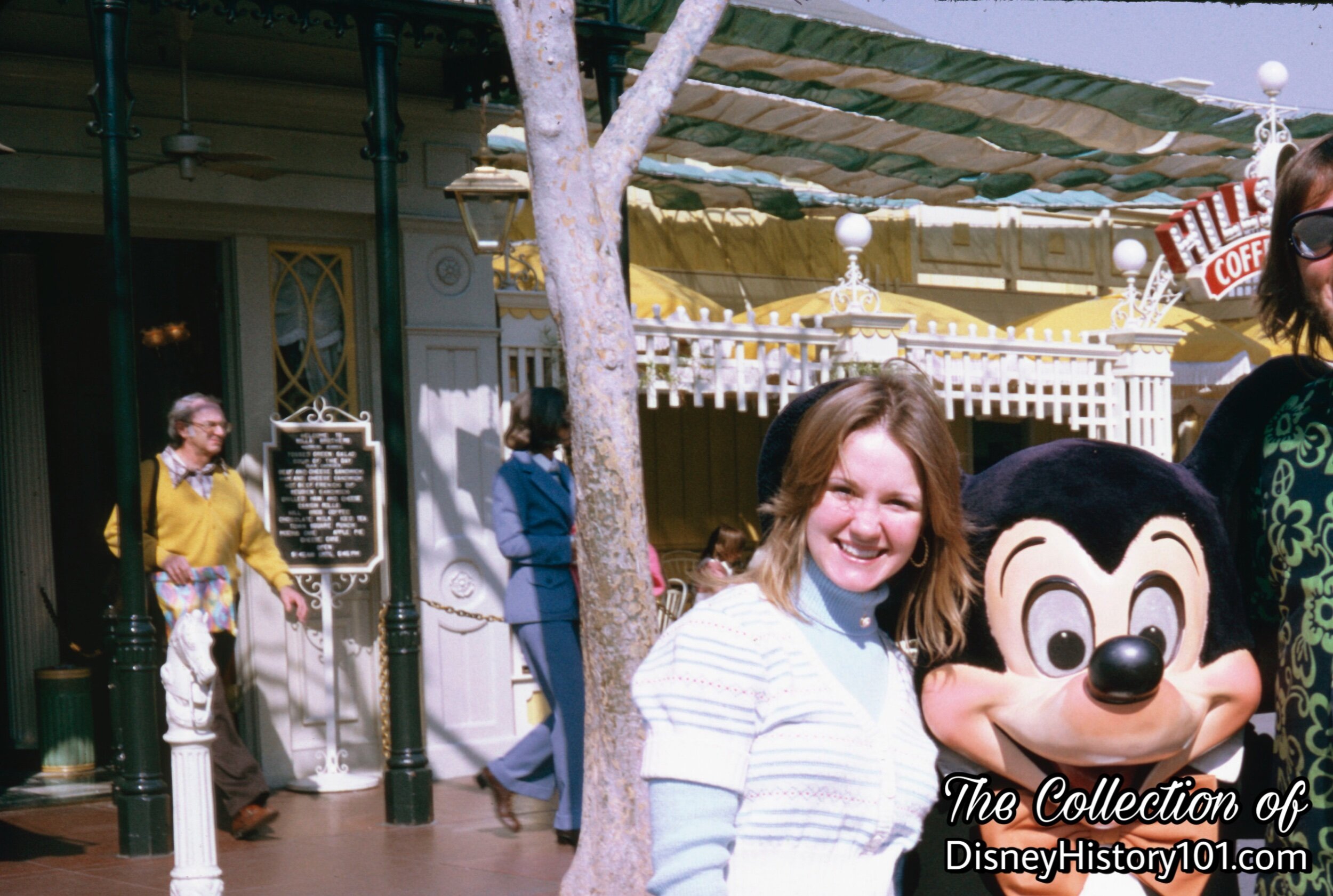
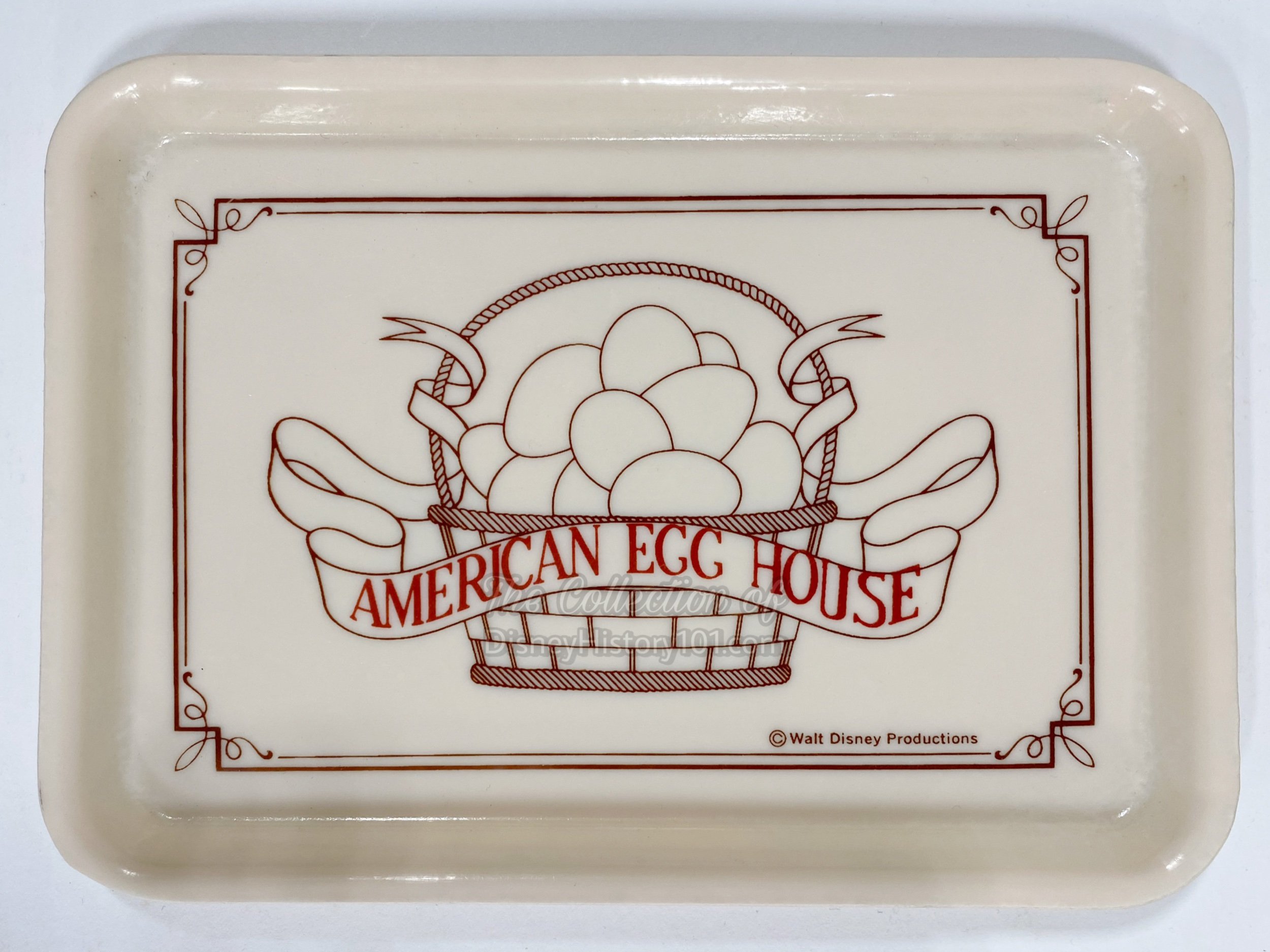
(July 14, 1978 - September 30, 1983)
The American Egg House (presented by the newest Disneyland Participant - the American Egg Board) opened next door to the Disney Showcase on Friday, July 14th, 1978. The restaurant was renowned for its Victorian Decor, Demonstration Chef, and Breakfast and Lunch Menus.
Much like its predecessor, the new restaurant offered table service in the dining room and on the patio and was open for breakfast, lunch, and dinner. The Grand Opening Ceremonies included culinary demonstrations by World Champion Omelet Maker - Chef Howard Helmer (of the American Egg Board), who prepared 217 two-egg omelets in 30 minutes, breaking the previous Guinness World Record of 188. [Disneyland LINE, July 20, 1978]
The American Egg Board advertised the highlight of their menu this way : “Eggs are nature’s most nearly perfect food. Low in calories and high in protein, eggs are economical - especially important in preparing nutritious meals at low cost. Eggs are versatile, too. They’re good at any time of the day…in an elegant soufflé or a quick and easy omelet…delicious any way you fix them. The Incredible Edible Egg - a natural wonder incredibly good so many different ways.” By 1981, the restaurant offered a few sandwiches, but their predominant focus was on egg-related dishes - the American Egg House Deluxe
Two Large Farm Fresh Eggs or Eggs and Steak (served any style), the Omelet Extraordinaire, Egg Salad Sandwich, California Omelet, the Spanish Omelet, the Omelet Delight, Egg Sandwich Supreme, Eggs Benedict, The American Egg Burger, Grilled Steak and Cheese Omelet, and the American Egg Burger (one fried egg on Canadian bacon, topped with American cheese, tomato and mushrooms, served in a sesame seed bun). Even the “Luncheon and Dinner Menu” offered many egg options - omelets, salads, sandwiches, quiches, merengues, and custards containing healthy American eggs.
A particularly popular specialty beverage was “The Instant Egg Pick-up” - “a blend of fresh egg, orange juice, and honey”! There were also plenty of Belgian waffle menu options as well as fruit dishes which included grapefruit, fresh melon, strawberries, fresh orange juice and tomato juice. Pastries and baked goods offered included warm danishes, blueberry muffins, English muffins, cherry pie a La mode, strawberry and ambrosia crepe, and cheesecake with strawberry topping.
In 1981, the American Egg House with its Victorian decor, demonstration chef, and breakfast and lunch menus produced $518,000 in revenue for Main Street Food. This was owning to VIPs of Disneyland (guests), its Main Street Foods hosts and hostesses (totaling 176 summer/118 fall), two Main Street Foods Stage Supervisors, and Main Street Foods Area Stage Supervisor.
Ultimately, Disneyland Participant Affairs and Disneyland Participant and Lessee American Egg Board could not negotiate a new cooperative agreement to maintain their ongoing relationship regarding this Location, so the two “reliable firms parted ways.” Though there were three sponsors in this location since 1955, the American Egg House would live on when this location would be referred to as the “Egg Gate.”
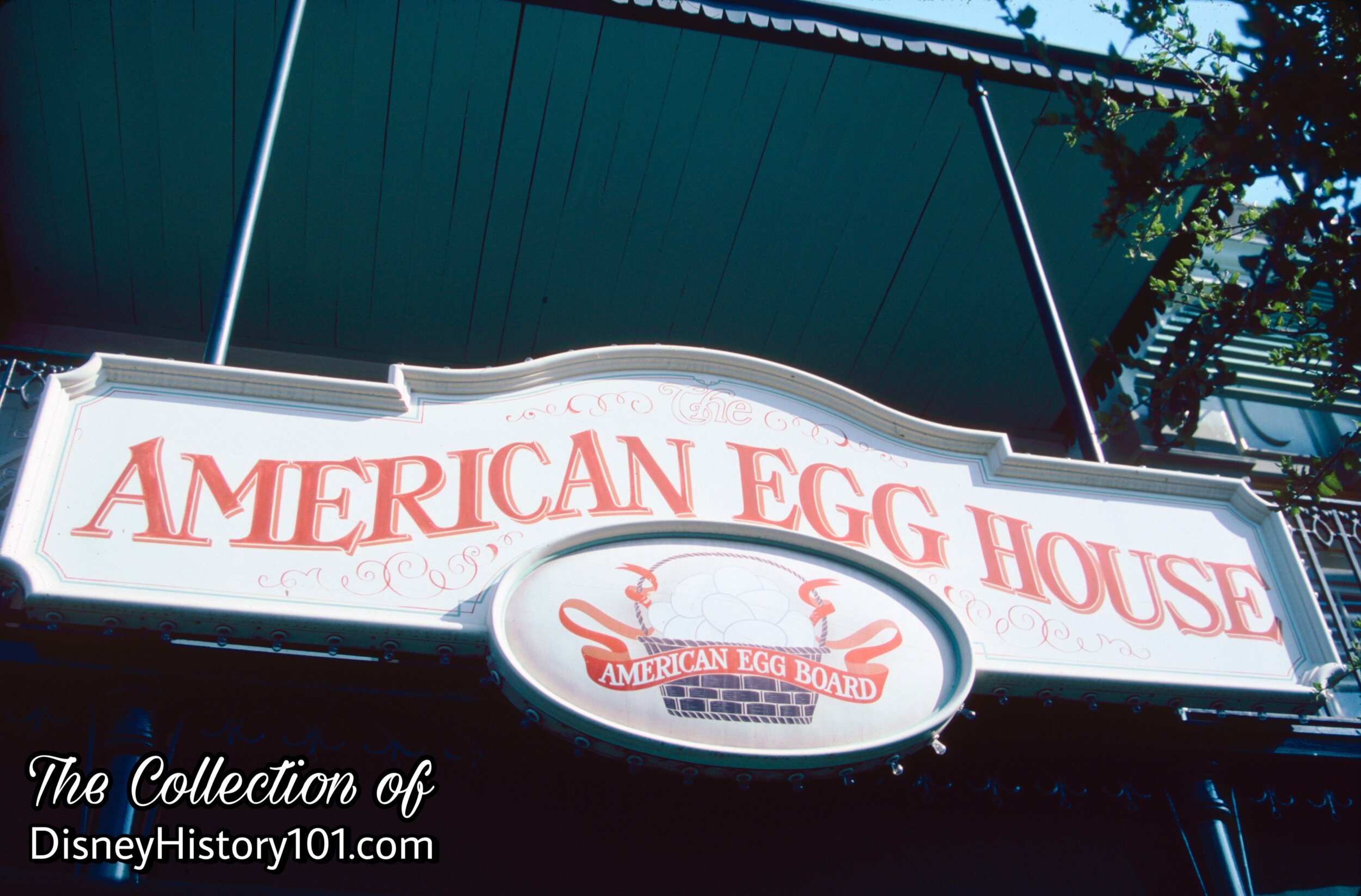
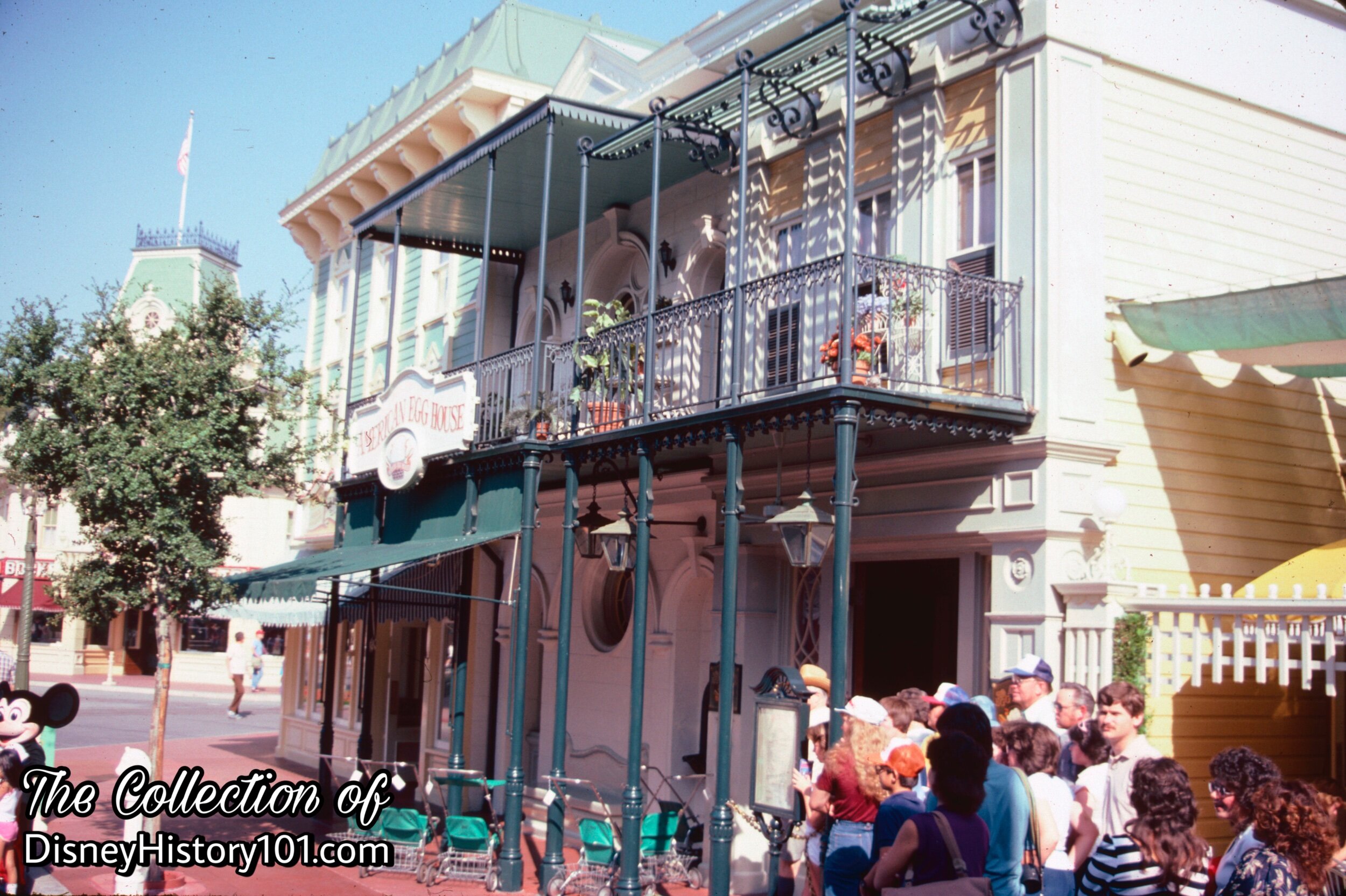

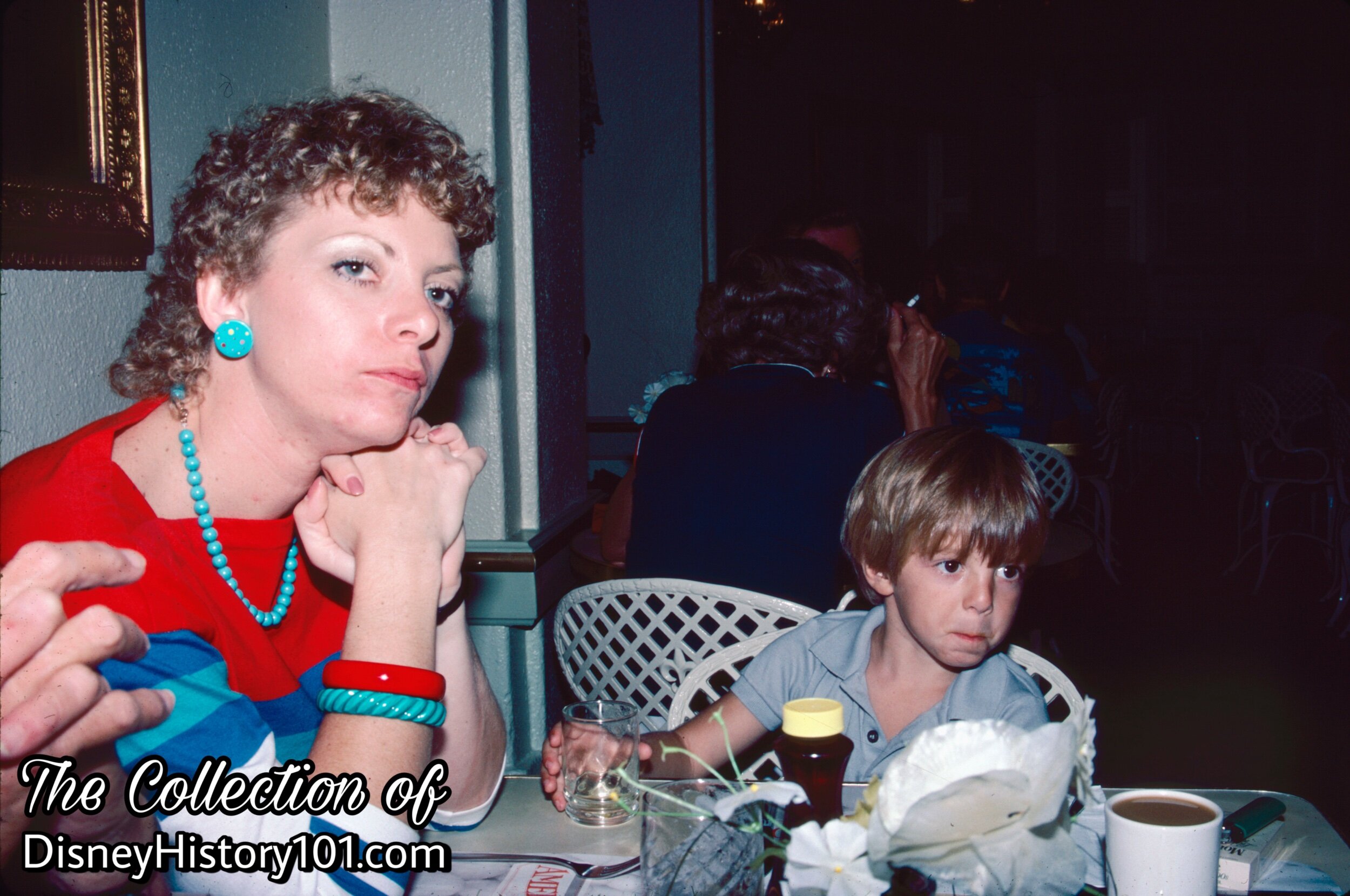
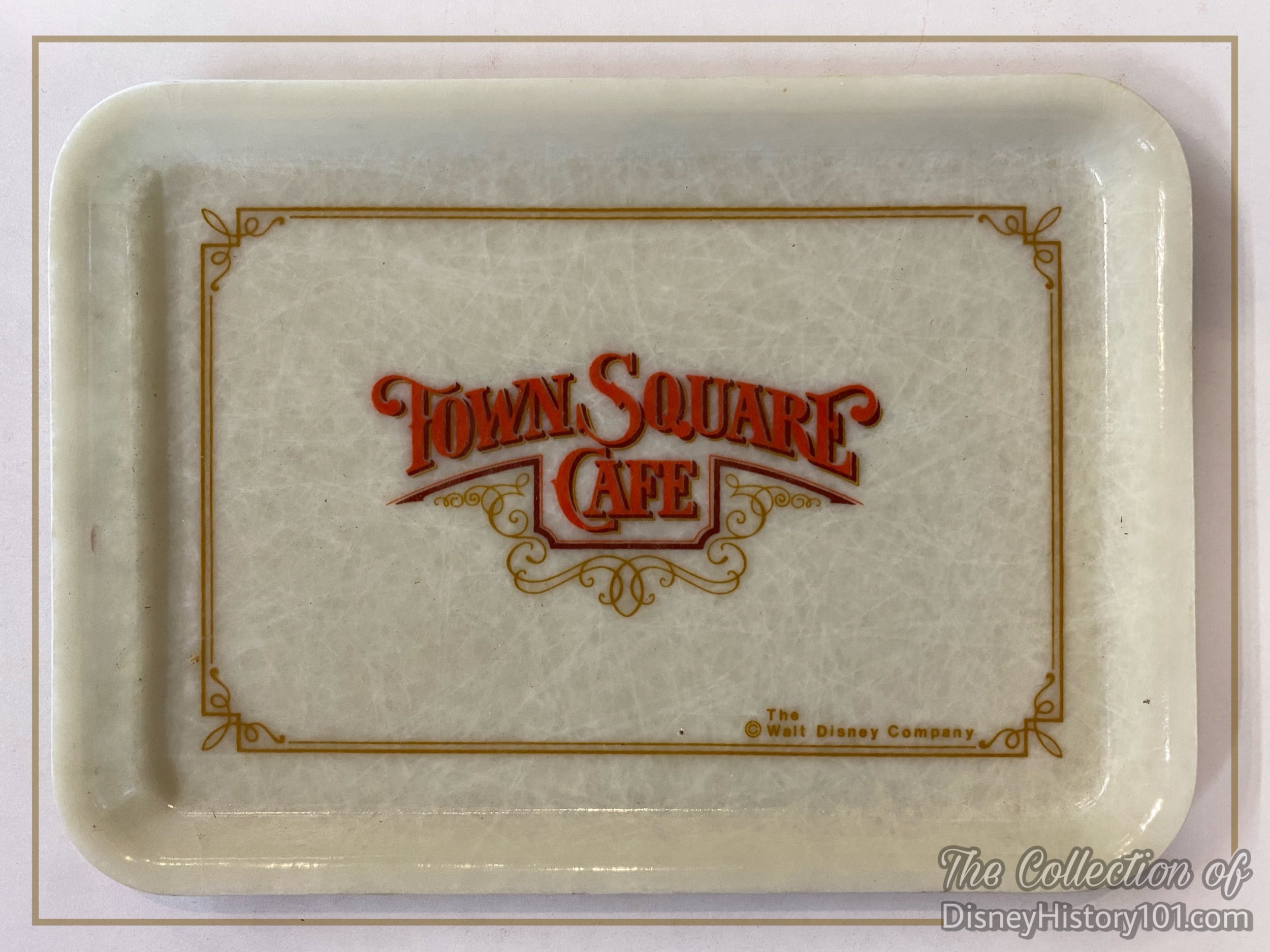
Town Square Cafe (winter, 1976 - spring, 1978)
The first incarnation of Town Square Cafe opened for lunch and dinner with a number of omelets - Omelet Extraordinaire (three farm fresh eggs, ham, American cheese, mushrooms, green onions, and chili salsa), the California Omelet (three farm fresh eggs, sliced avocado, diced tomato, alfalfa sprouts, sour creme, and pine nuts), the Spanish Omelet (three farm fresh eggs, diced tomato, green Ortega chilis, Spanish sausage, green onions and cheese), and the Omelet Delight (three farm fresh eggs, ham, and American cheese)! Town Square Cafe also offered salads including the Seafood Louis (with pink shrimp, tuna, crisp greens, Louis dressing, hard-boiled egg, and lemon wedges). Other offerings included several choices of burgers (Ortega Cheese, Avocado and Bacon, Bacon Cheese, and the Original Hamburger Platter), the Fire House Favorite hot dog, a couple of sandwiches (Steak Sandwich and the Club Sandwich), desserts (Apple Pie, Cherry Pie, Cheesecake with cherry topping, Cinema Sundae), and plenty of beverages (including coffee, soft drinks, tea, hot cocoa, and milk).
Town Square Cafe (October 1, 1983 - August 23, 1992)
The new Town Square Cafe restaurant offered table waitress service, and was “a great place for breakfast and lunch with a menu featuring eggs, omelets, hamburgers, specialty sandwiches, salads, and desserts.” In addition, healthier menu options - Chicken Breast Sandwich, Chef’s Salad, Seafood Louis, and Omelettes with less cholesterol - were now available to guests! The Town Square Cafe occasionally hosted special events, like Private Parties (e.g. GM and Hughes Employees, January of 1986).
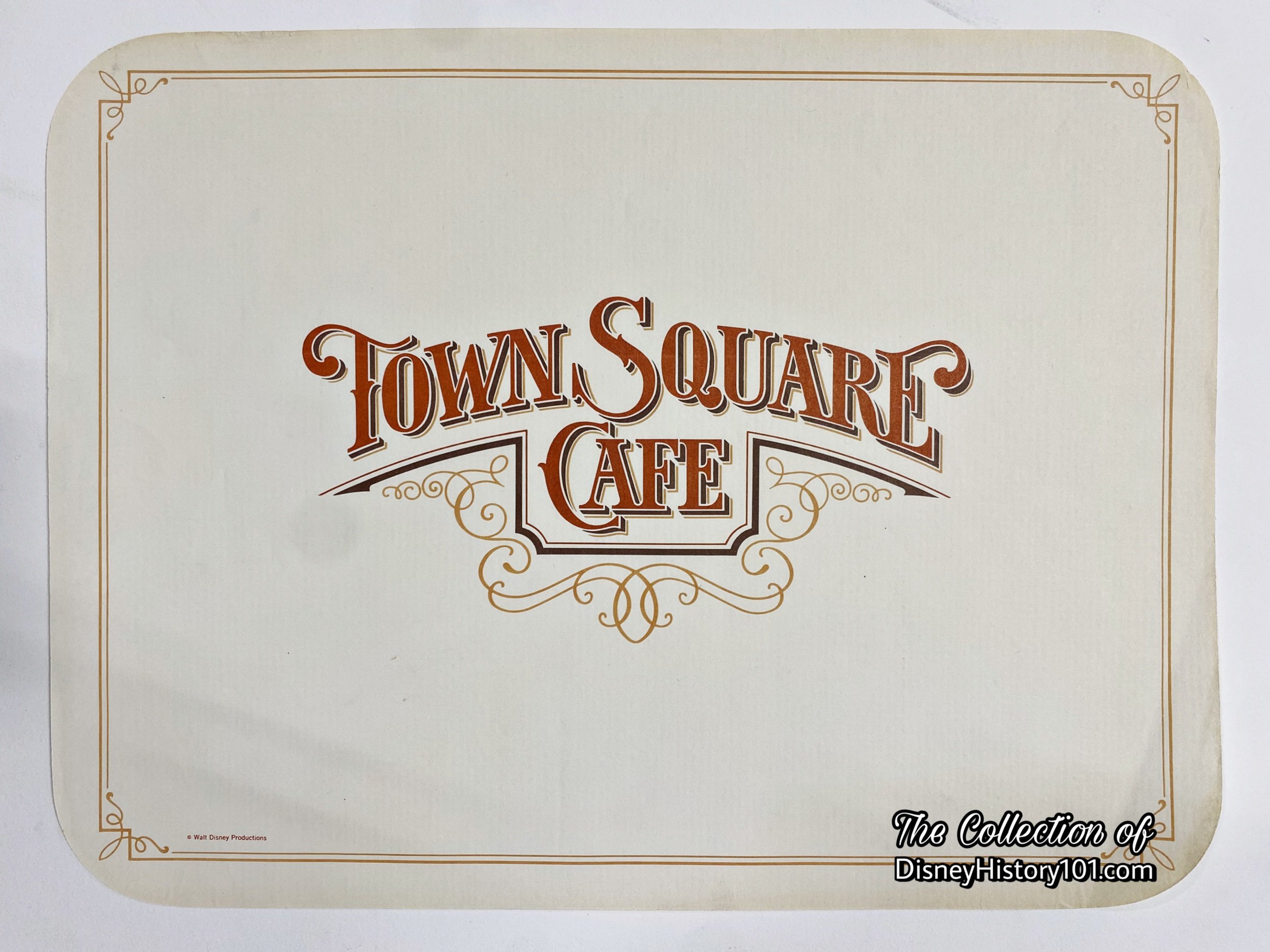
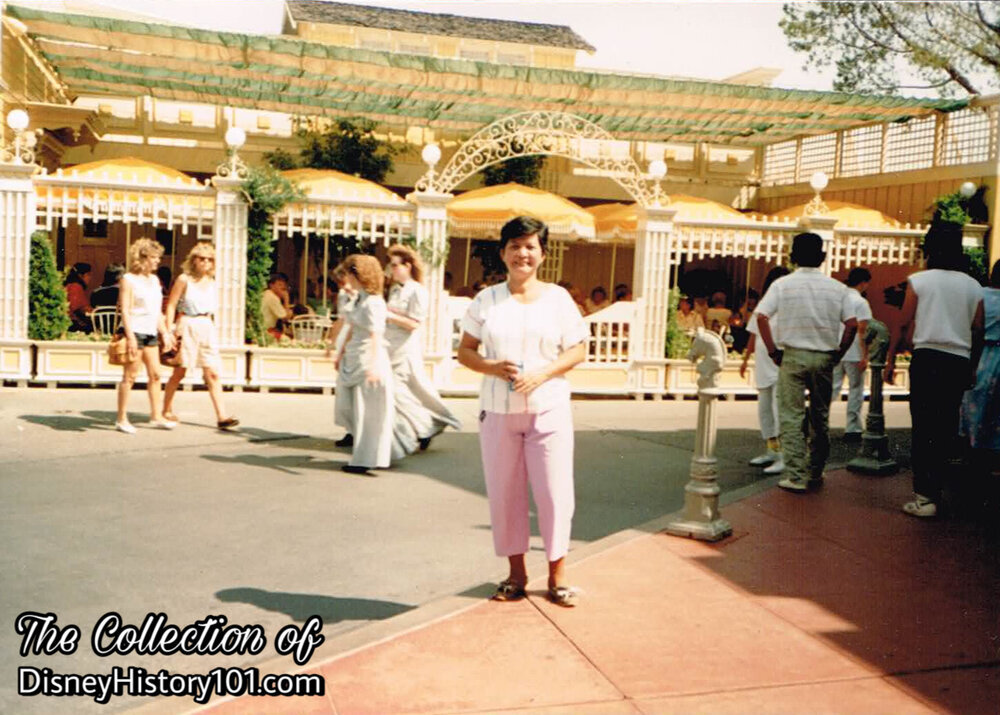
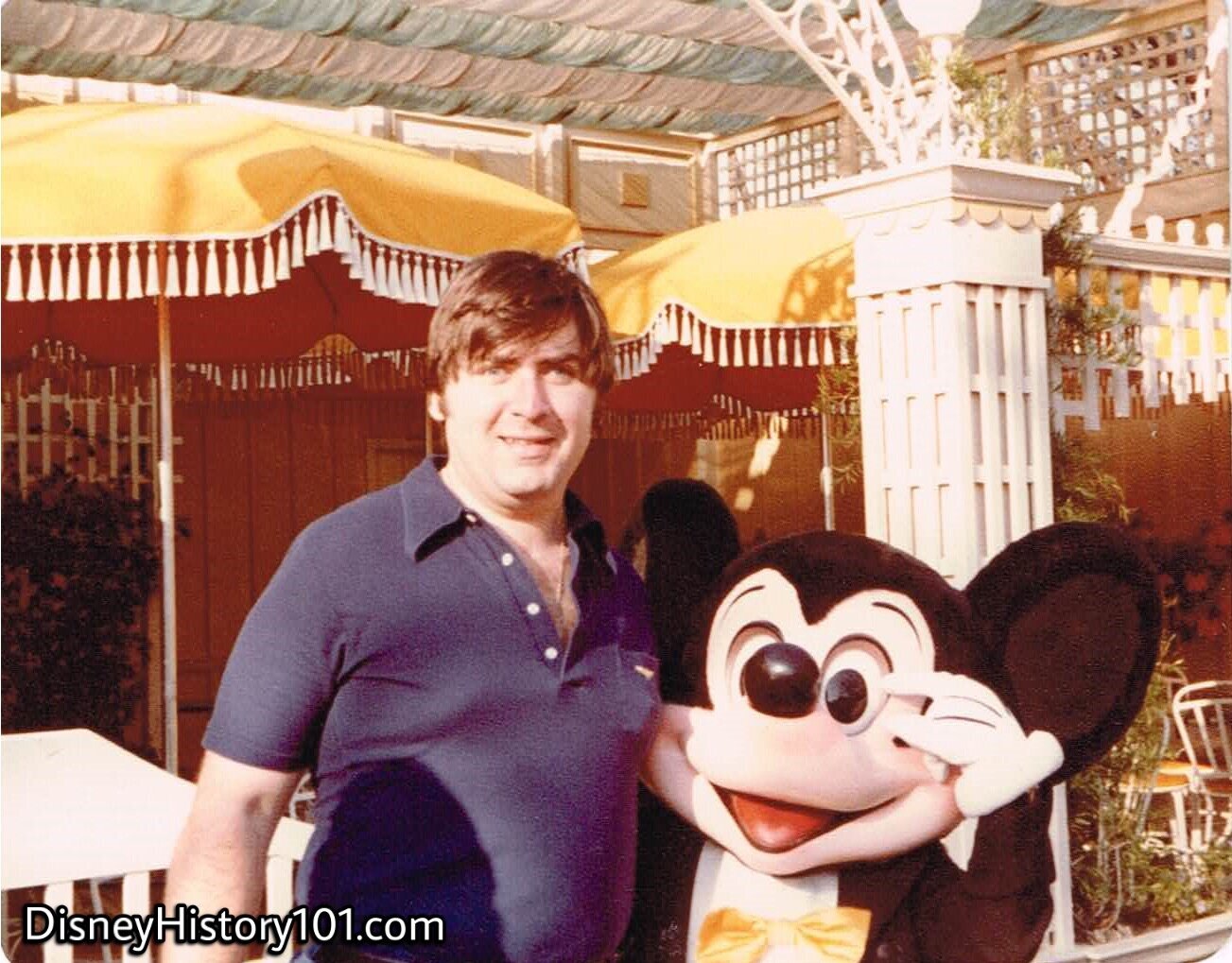
The Disney Characters often walked close-by the Town Square Cafe Patio.
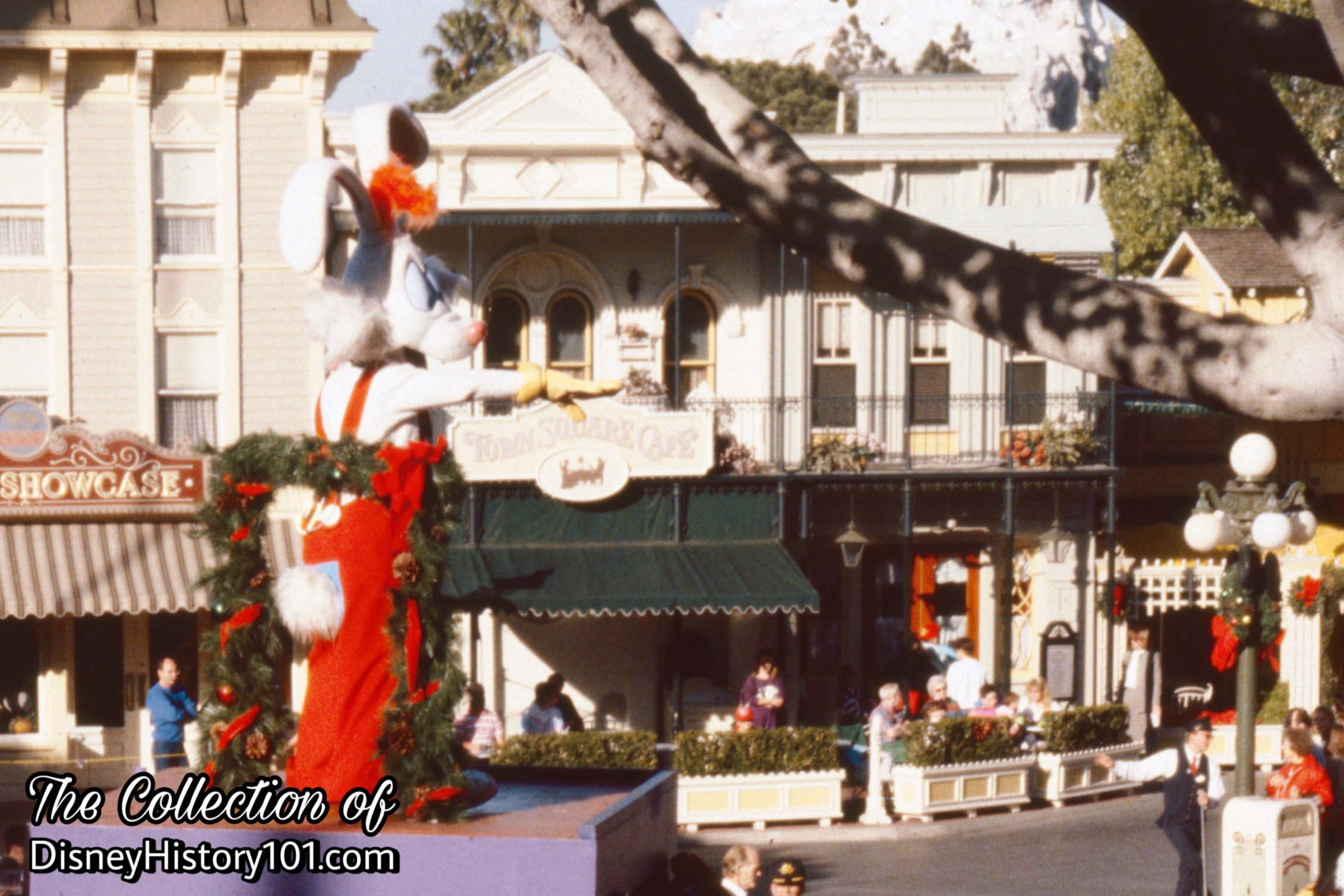
The Town Square Cafe Patio also offered a fantastic view of parade units (as in this Vintage View which may have preserved a moment of Roger Rabbit’s very first Christmas, during December of 1988). Through the years, Parade Units would often headed from the “Parade Formation Area” and out of the old Hills Bros. Gate (also known as the Egg House Gate).
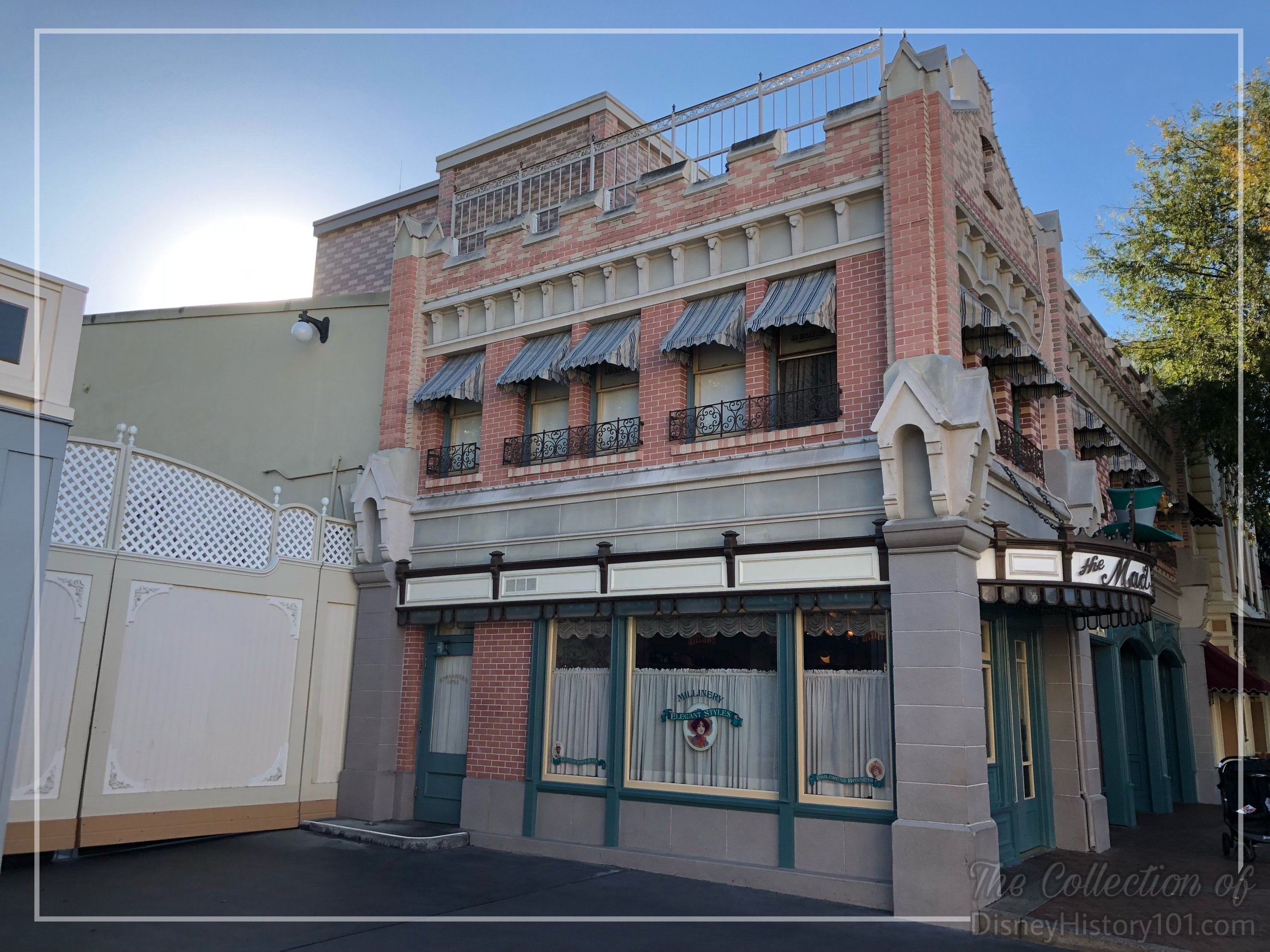

MIDGET AUTOPIA

*Some sources (as “Disneyland Admission Media Rides and Attractions” report, page 40, published 1971; “Disneyland Rides & Attractions and Attendance Report,” 1981, page 50) cite April 13th, while other sources state April 27th as the opening date.
One can easily slip into the jargon of “ride,” but at Disneyland there is a "story behind the story" of every attraction, every attraction is a living experience for the guest. Disneyland ride-through attractions or adventures have officially been defined as an “individual show, ride, or exhibit designed to produce an entertaining Guest experience. Disney attractions stir the imagination, enliven the senses, and provide the participants with positive, innovative entertainment, which is the essence of the DISNEYLAND Show.” It is important to review the story of the attraction, tell the story, explain it, and create interest. This is the story of the Midget Autopia.
While the term “Midget” is antiquated, “midget” racing was popular during the 1950s and 1960s! There were racing tracks in places (like the San Fernando Valley, California), where kids brought their “quarter midget race cars” in order to compete. Testifying to the popularity of “midget” race cars, Walt Disney’s Magazine (Vol. IV, No. 1) contains a story on one eleven-year-old “Quarter Midget Champion” who had won more than 200 racing trophies by the time the article was published.
Back on the eve of Disneyland’s first day of operation, Walt Disney had promised that “Disneyland will never be completed. It will continue to grow, to add new things, as long as there is imagination left in the world.” One new attraction (one of the smallest) would be accounted among the major additions to the Park. In 1957 it would open the Midget Autopia in Fantasyland. This would be the third Autopia track - and the smallest one. It’s a fact that the "little things" can make a big impression, as was proven by the memorable Midget Autopia at Disneyland!
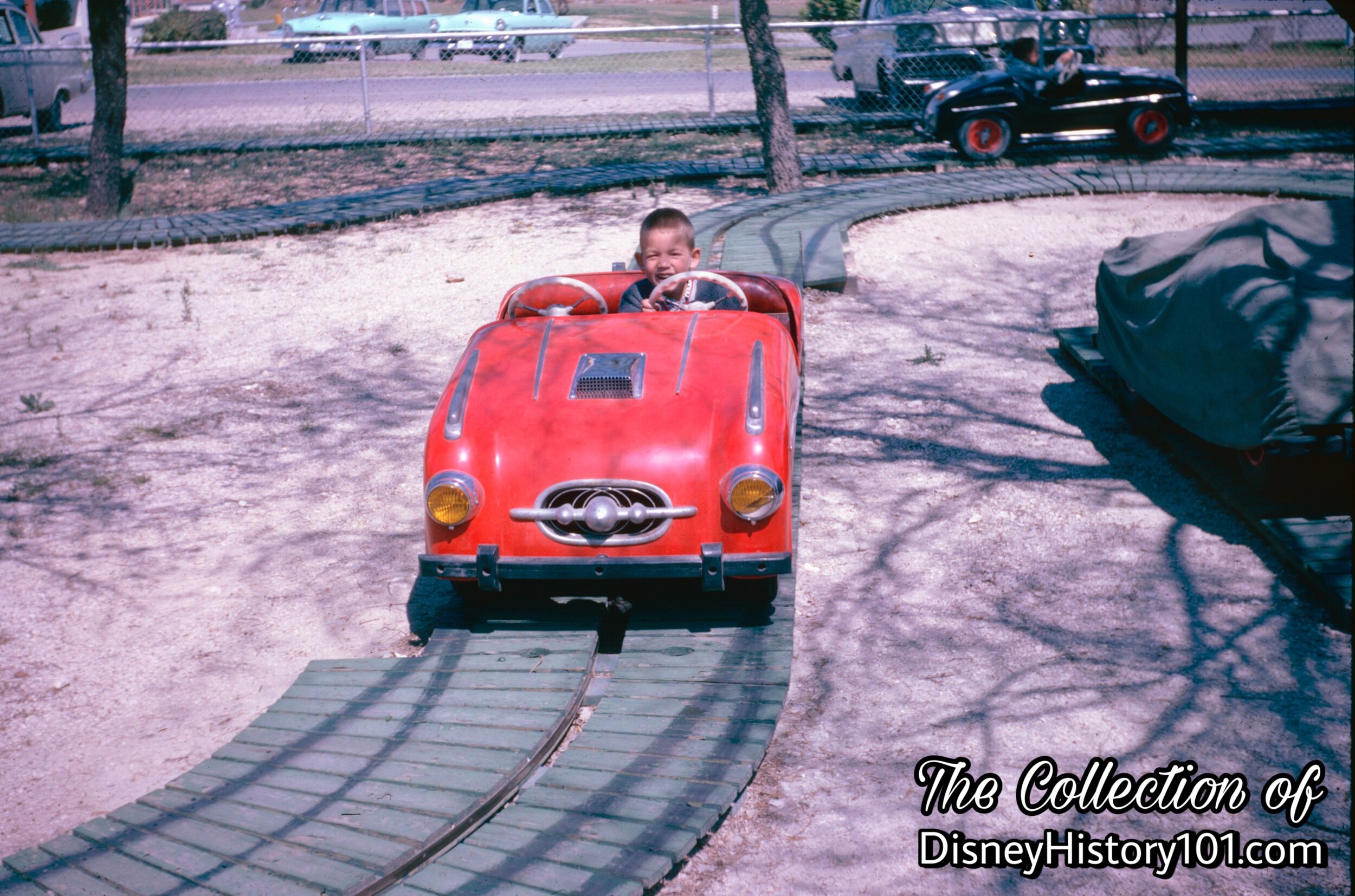
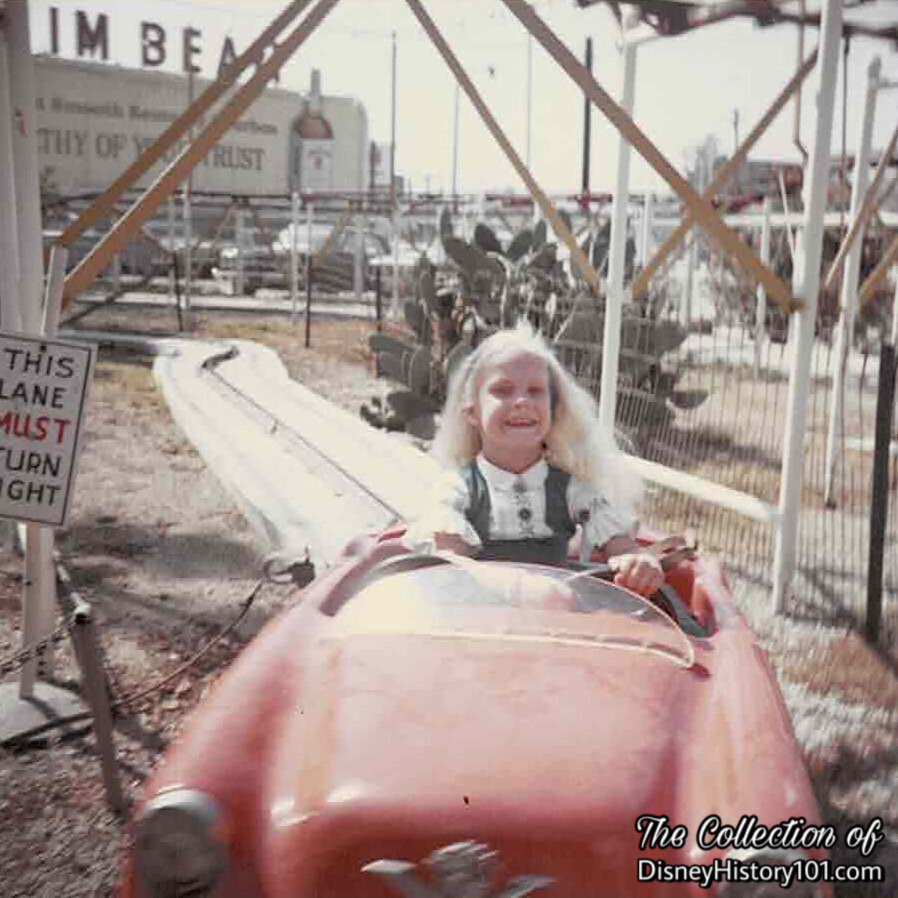
Many other contemporaneous amusement parks (across the United States and Alaska) had already installed Arrow-Flite “Tracked Auto Rides” by 1957. There was Easbey Amusement (in Palo Alto, California), Gold Coast Shows (in San Jose, California), Woodland Park (in Seattle, Washington), Nu-Pike (of Long Beach, California), Peppermint Parks (of Houston, Texas), Shanahan (of Anchorage, Alaska), and Wards (of Coney Island). So, from that standpoint, this wasn’t a new attraction, but the custom cars and other imaginative story elements along the track made the Midget Autopia a truly unique Disneyland adventure!
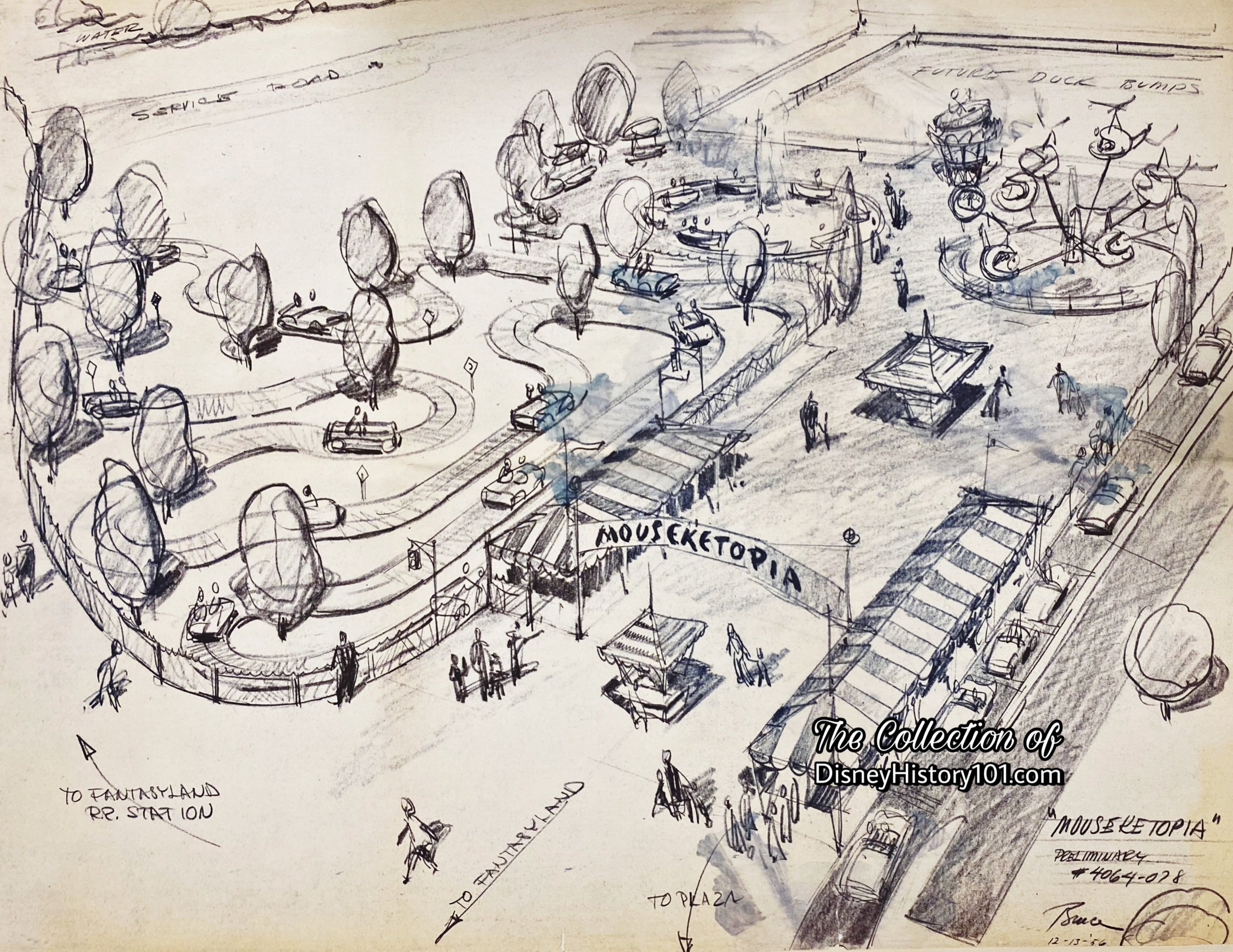
Remember that Walt Disney had earlier said : “Disneyland will never be completed. It will continue to grow, always adding new things to provide its visitors with exceptional and entertaining attractions.” In Walt’s eyes, Disneyland was “like a piece of clay,” because if there was something he didn’t like, he wasn’t stuck with it. He could reshape and revamp it. After years of personally reshaping and revamping, Walt divulged: “I’m not the perfectionist anymore. It’s my staff - they’re the ones always insisting on doing something better and better.”
Bruce Bushman created an untold number of concept illustrations of “Mouseketopia”, a Mickey Mouse-themed Autopia track.

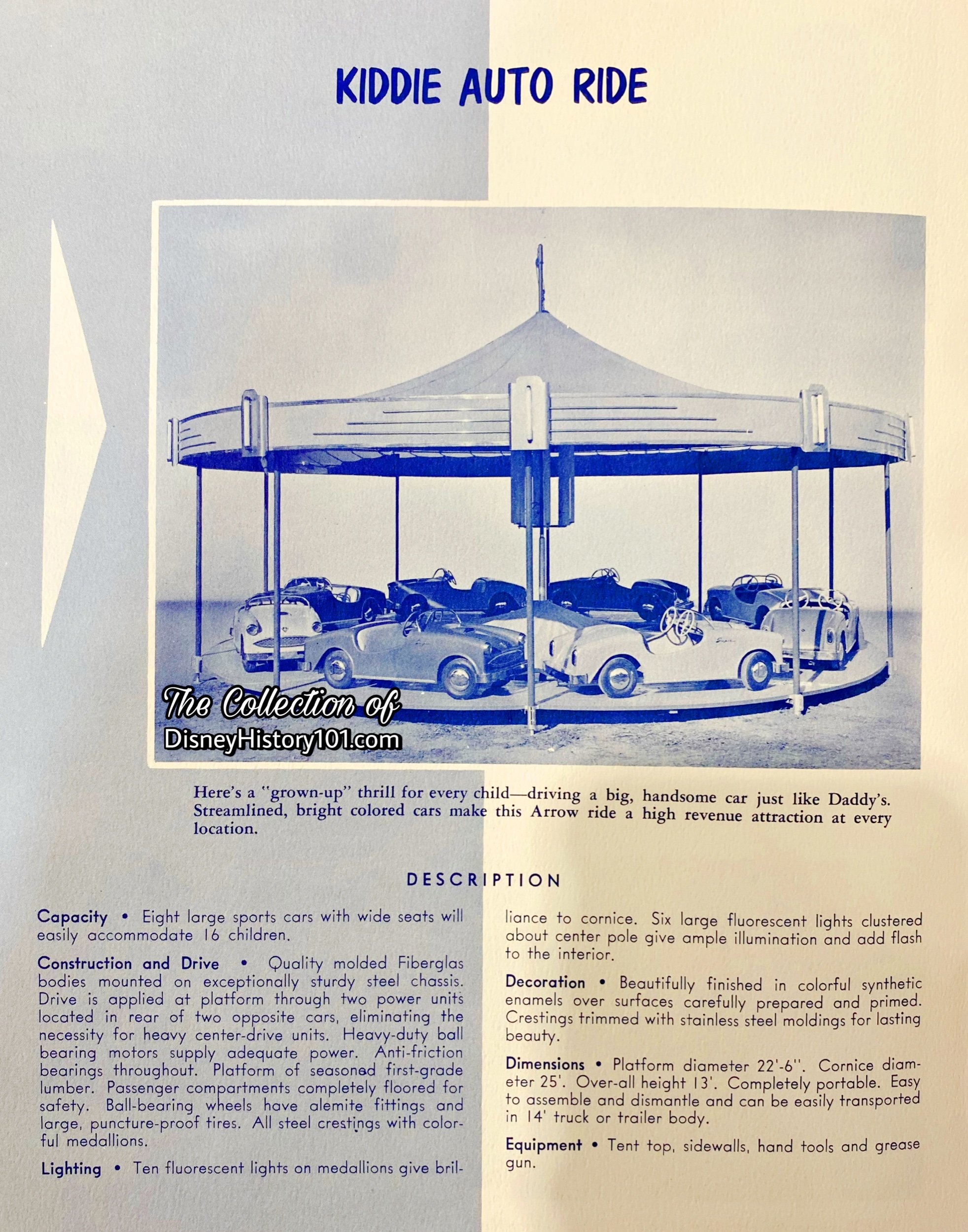
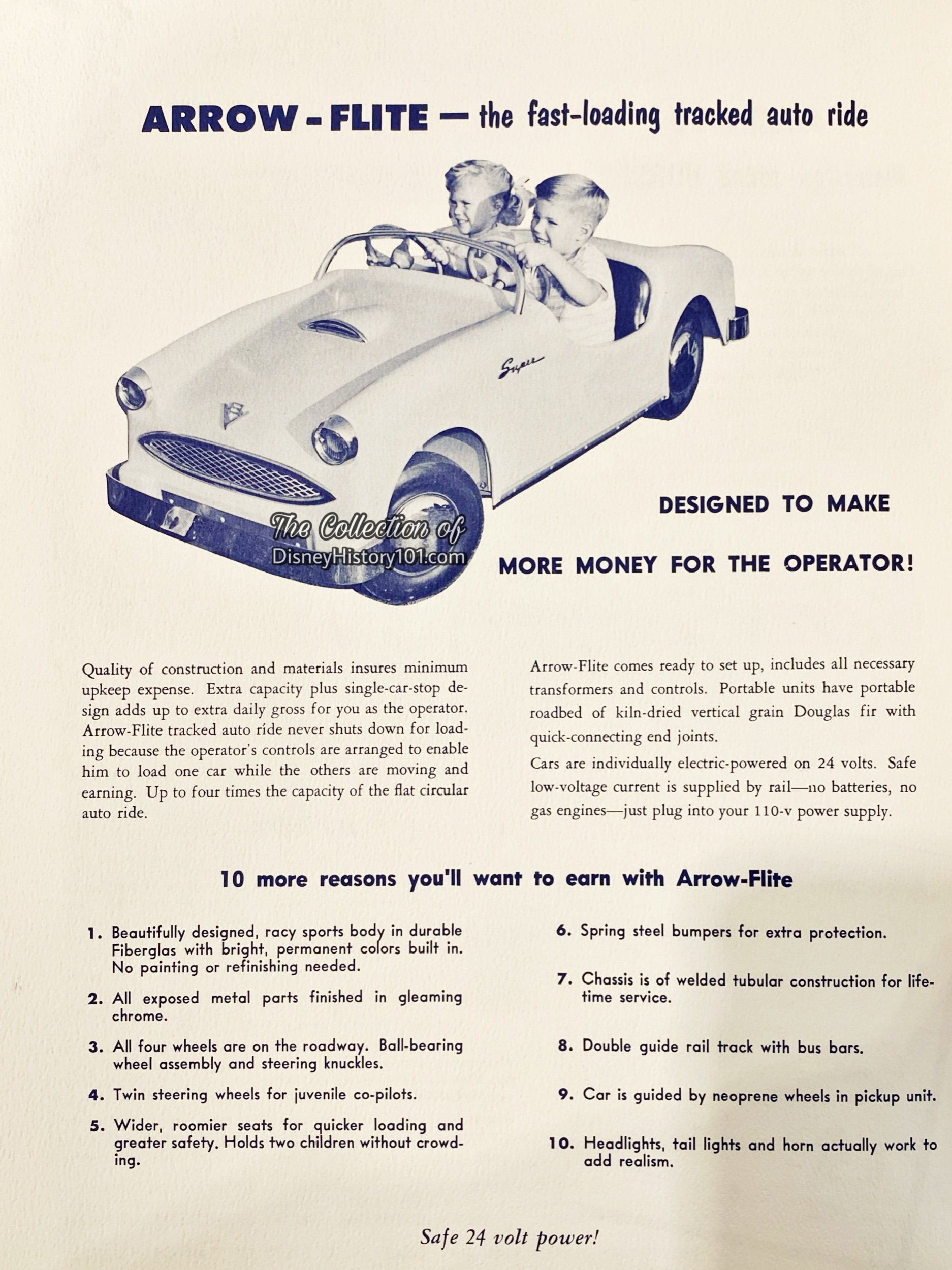
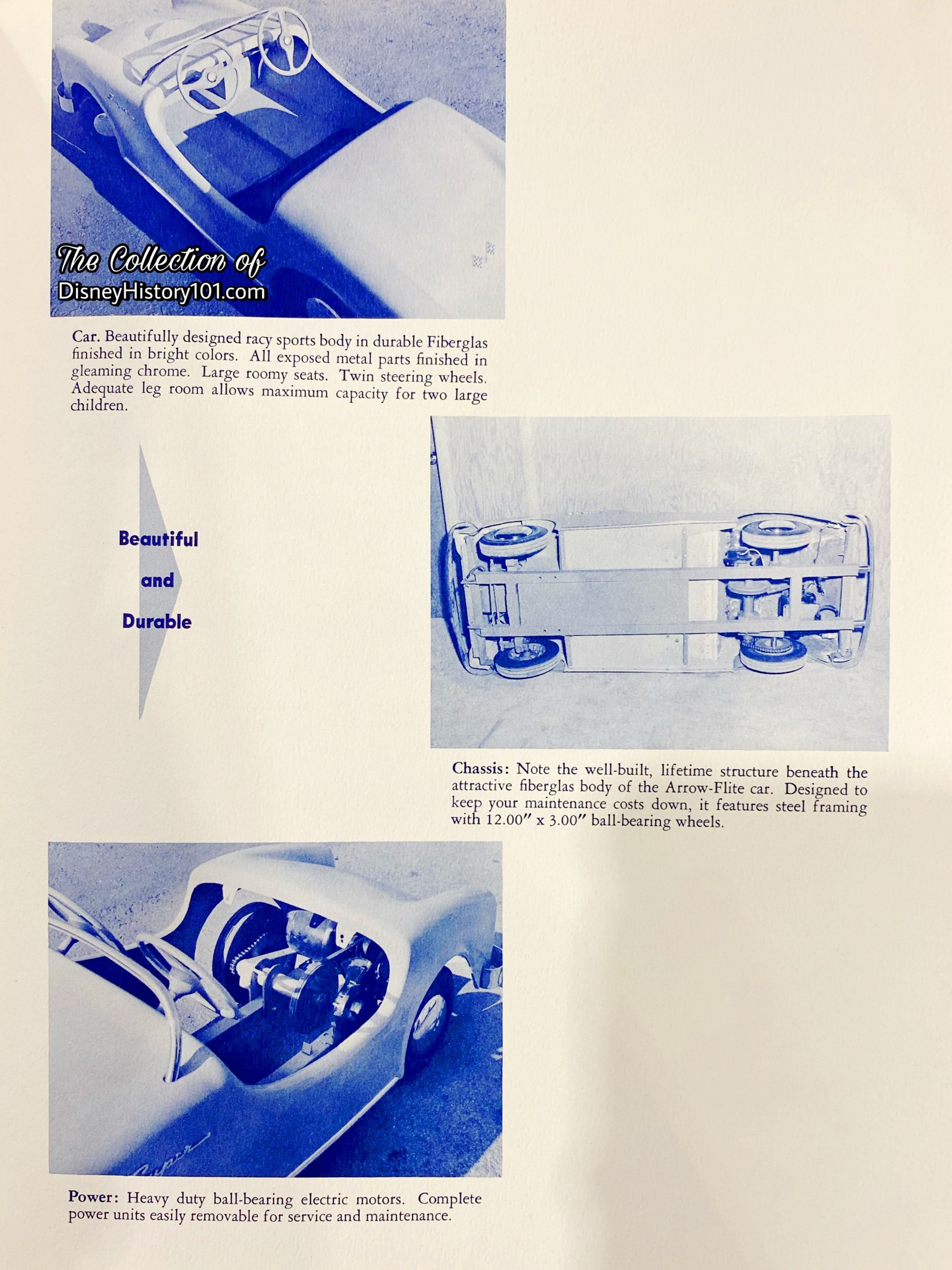
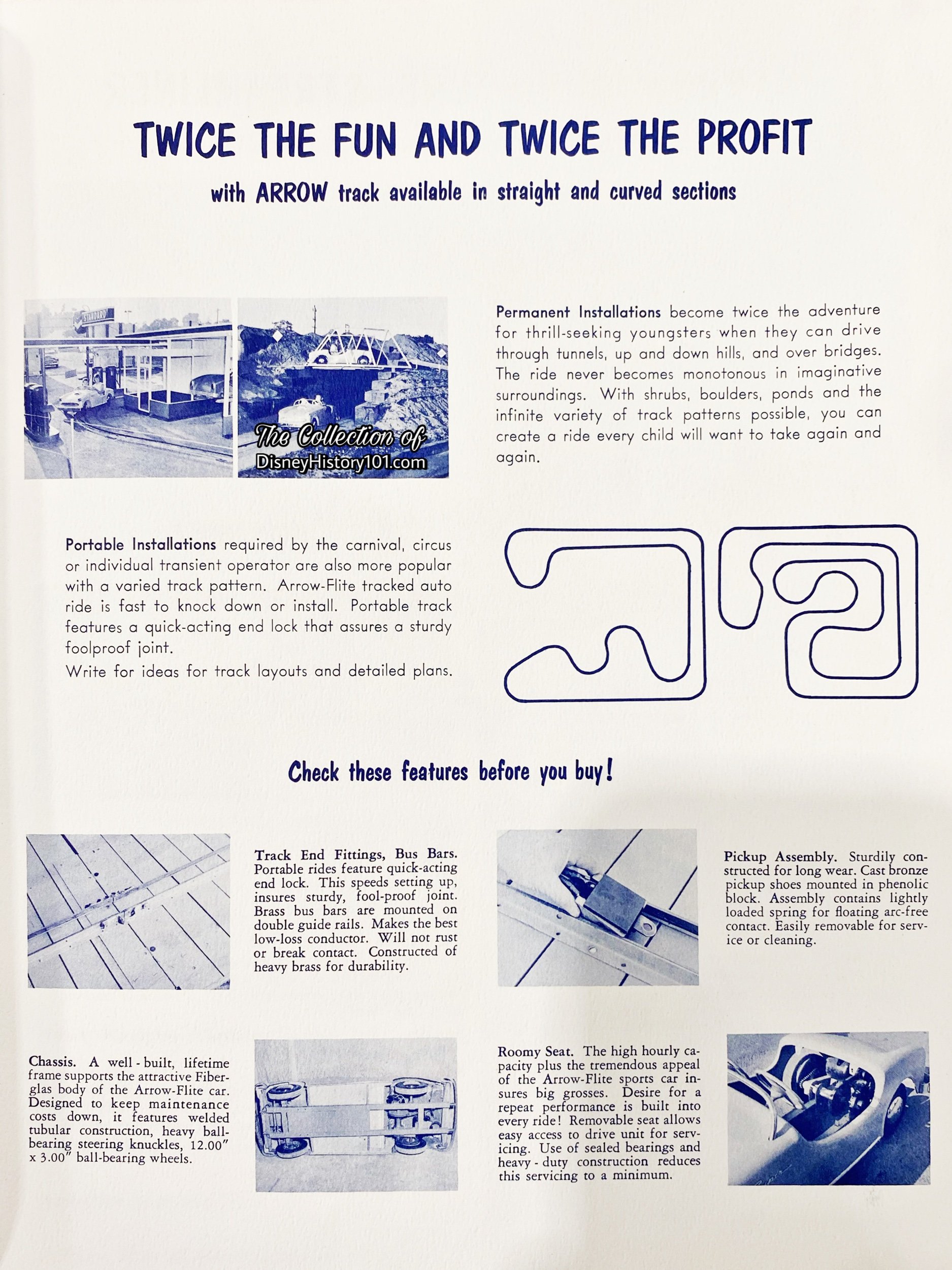

The ten Midget Autopia vehicles were manufactured by Arrow Development (who had built another fleet of these “Arrowflite” series vehicles for Idlewild Park in Pennsylvania).
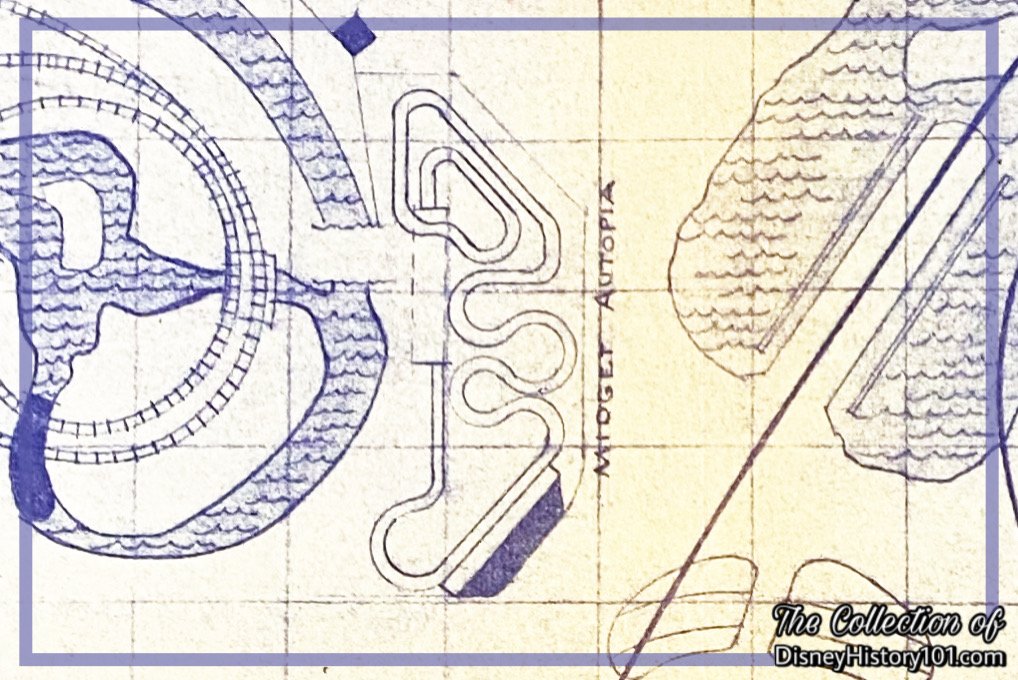
Additionally, the Disneyland Midget Autopia would hold the record for the first Autopia track to have a center Guide Rail. The A/C power ran along one side of the rail, powering the electric motors of the vehicles. Joe Fowler (Disneyland Operations Committee) oversaw the Construction & Maintenance division including Engineering, New Construction, Maintenance, and Janitorial related to the installation of the attraction.
Once complete, the “ride structure” (passageways and sets) of this amusing adventure was appraised at a value between $25,300 and $27,600, while the equipment was valued between $5,250 and $6,300.
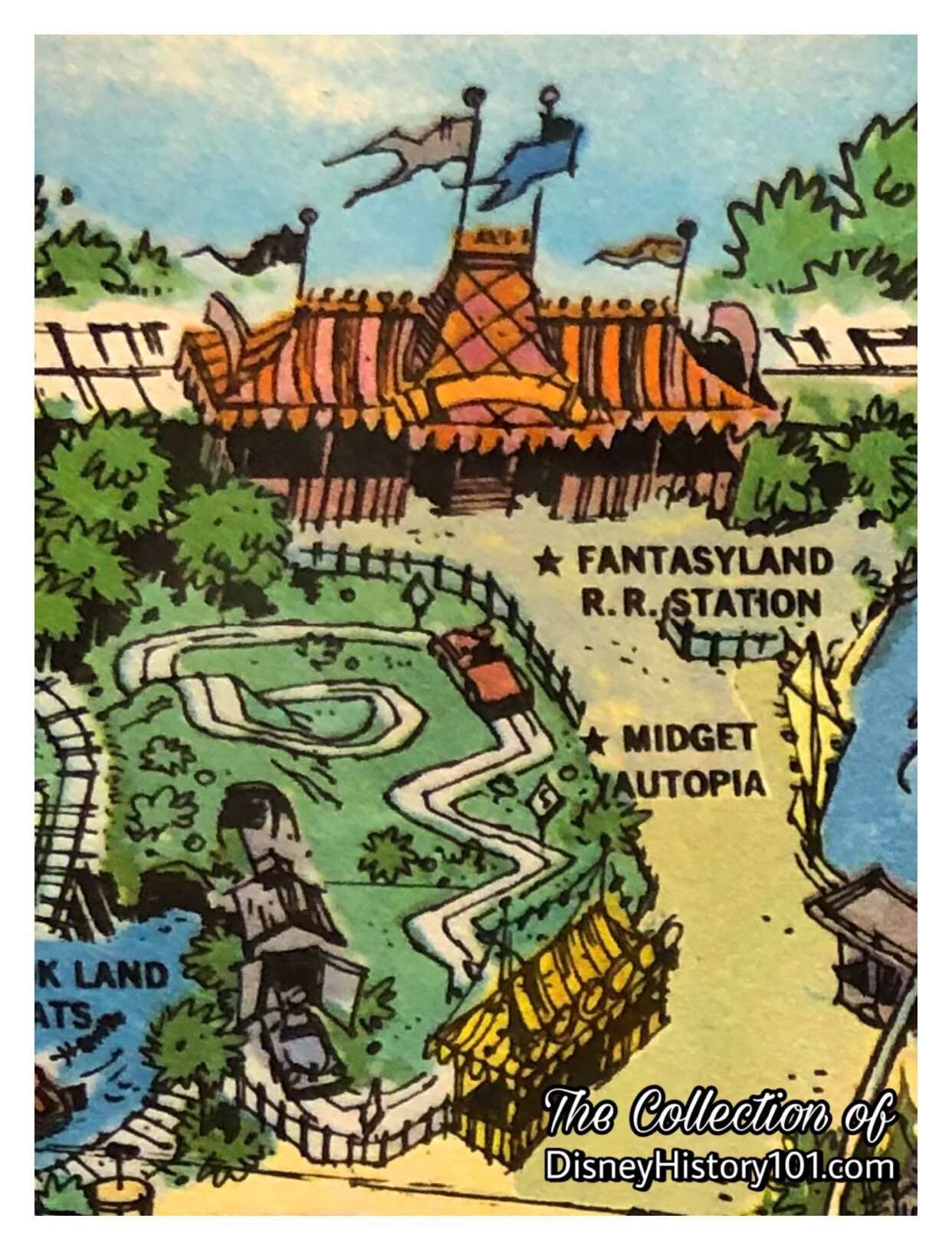
In this map excerpt (pictured above), we can see that the Midget Autopia was one of the first attractions to greet younger guests near the Fantasyland Station. It was located near another “lilliputian” attraction - the Storybook Land Canal Boats! According to 1959 advertisements, the Midget Autopia was “a special ‘auto’ ride” for “the ‘small fry’ too young to drive the Super Autopias.” Yes, Disneyland guests that were too small to drive the Tomorrowland and Fantasyland Autopia cars, could sit behind the wheels of their very own two-passenger car.
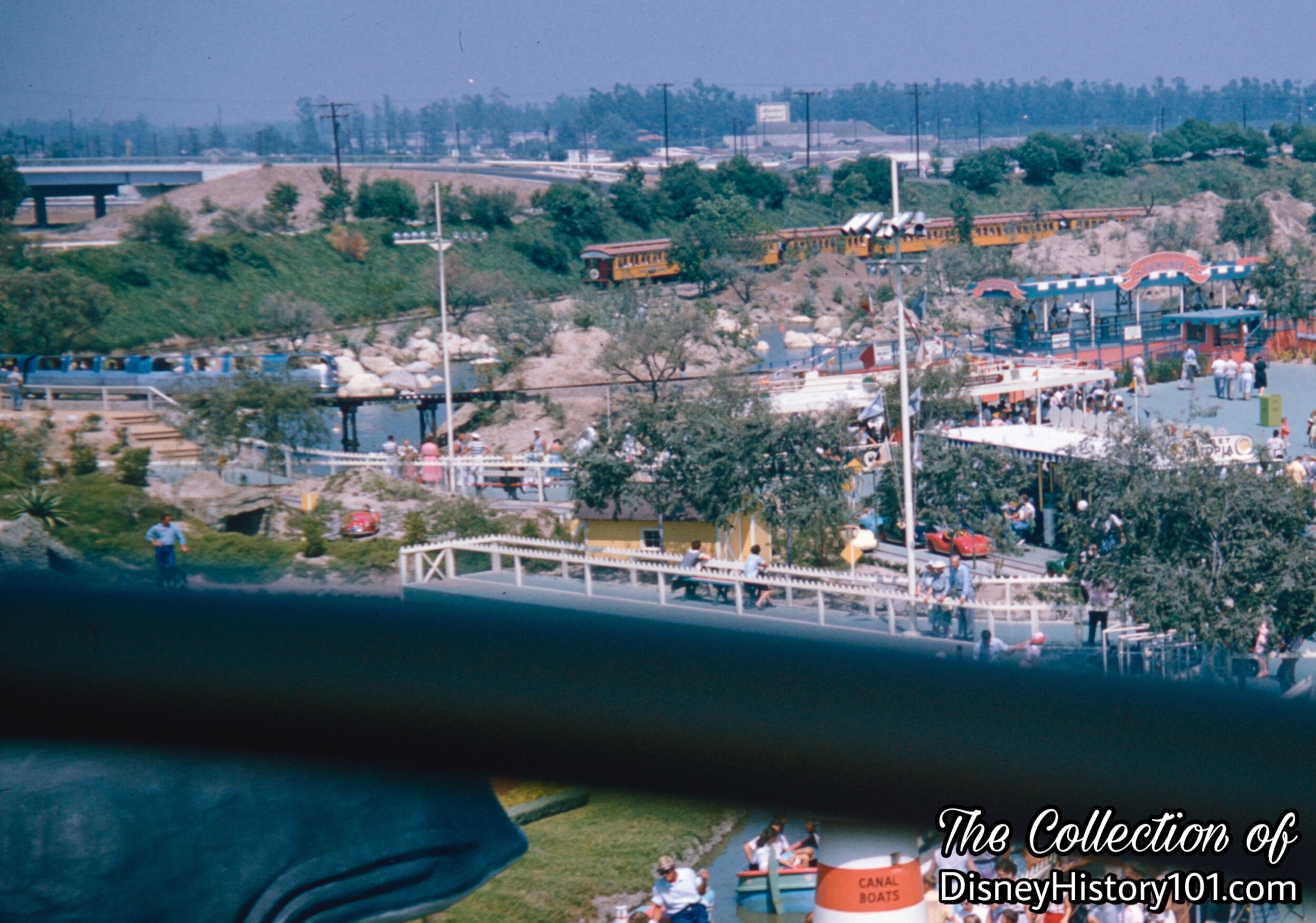
Skyway Cabins once offered an aerial preview of Fantasyland attractions and adventures, including the Santa Fe & Disneyland Viewliner train and Midget Autopia.
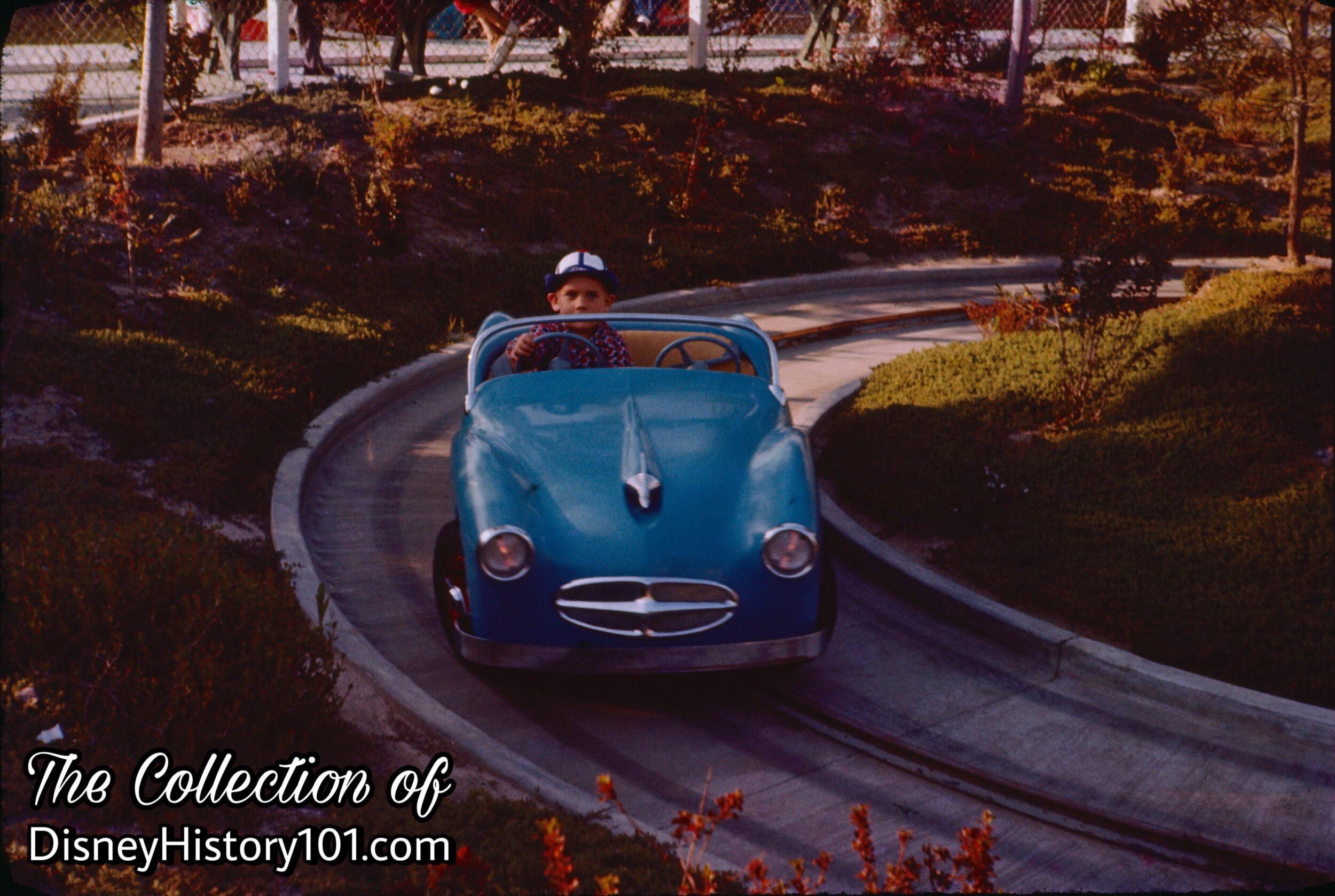
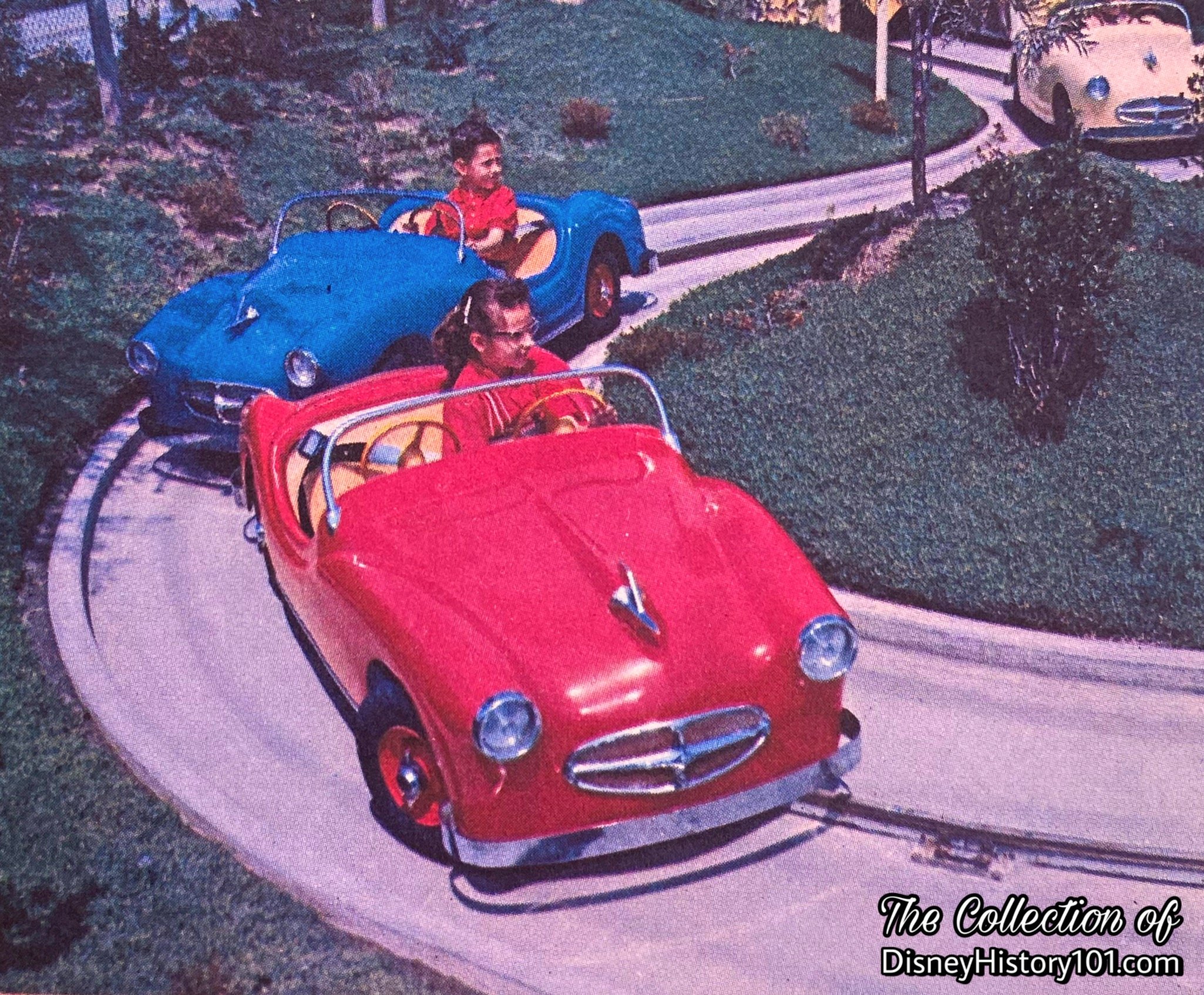
“Follow the leader, obey all the rules,
You're driving Autopia style.
This highway is play,
All the traffic's one way,
And the rule of the road is smile.”
The Midget Autopia was featured in several pieces of promotional media including “An Adventure in the Magic Kingdom” (April 9, 1958) and one Mickey Mouse Club Newsreel.

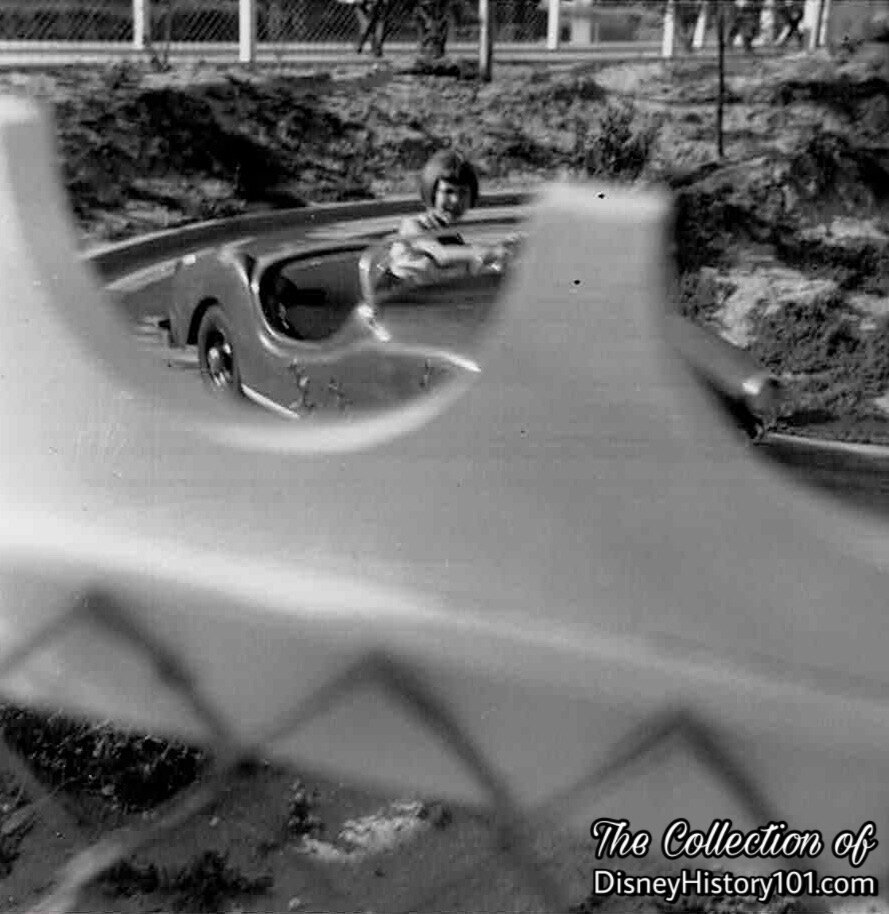
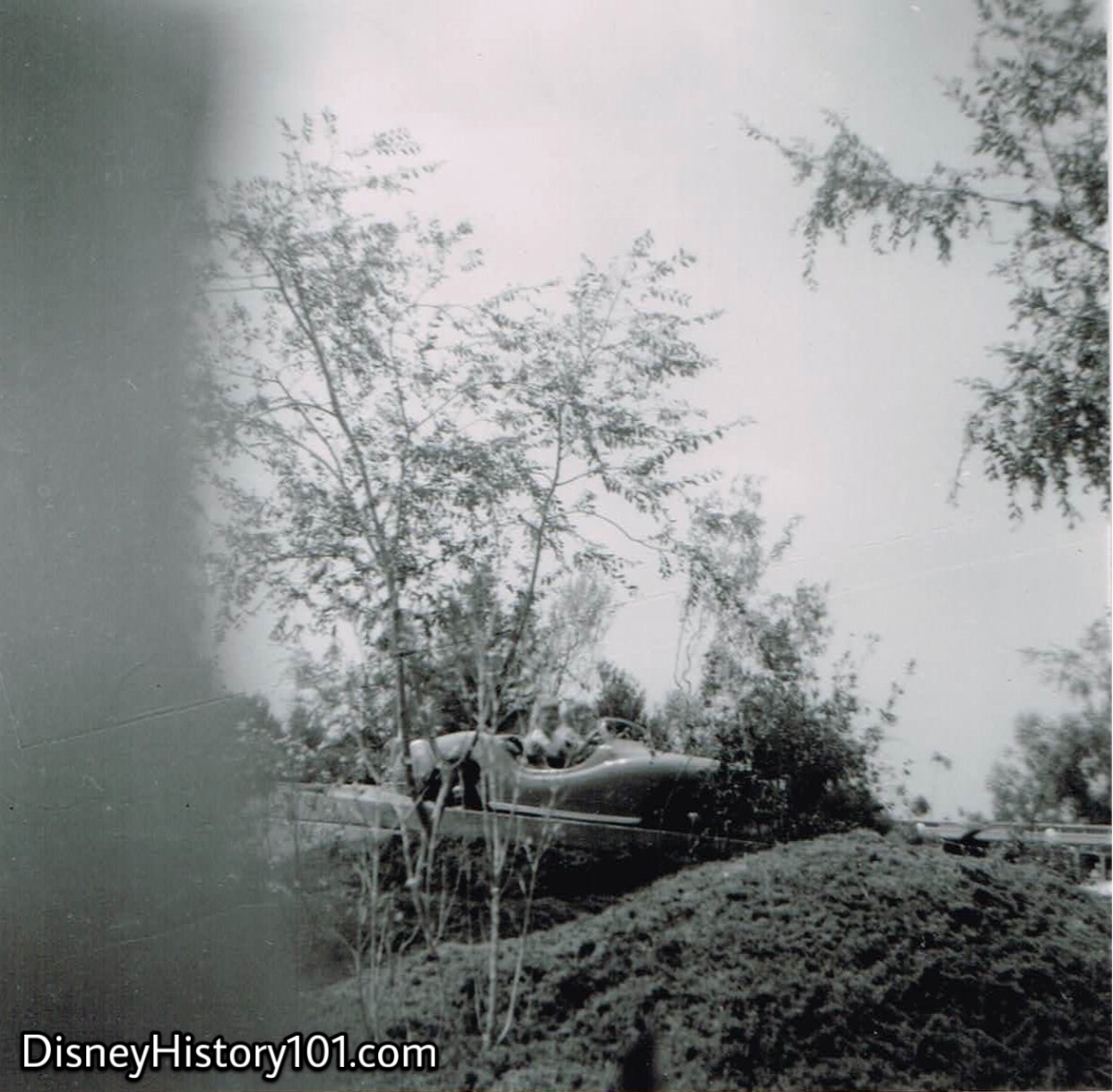
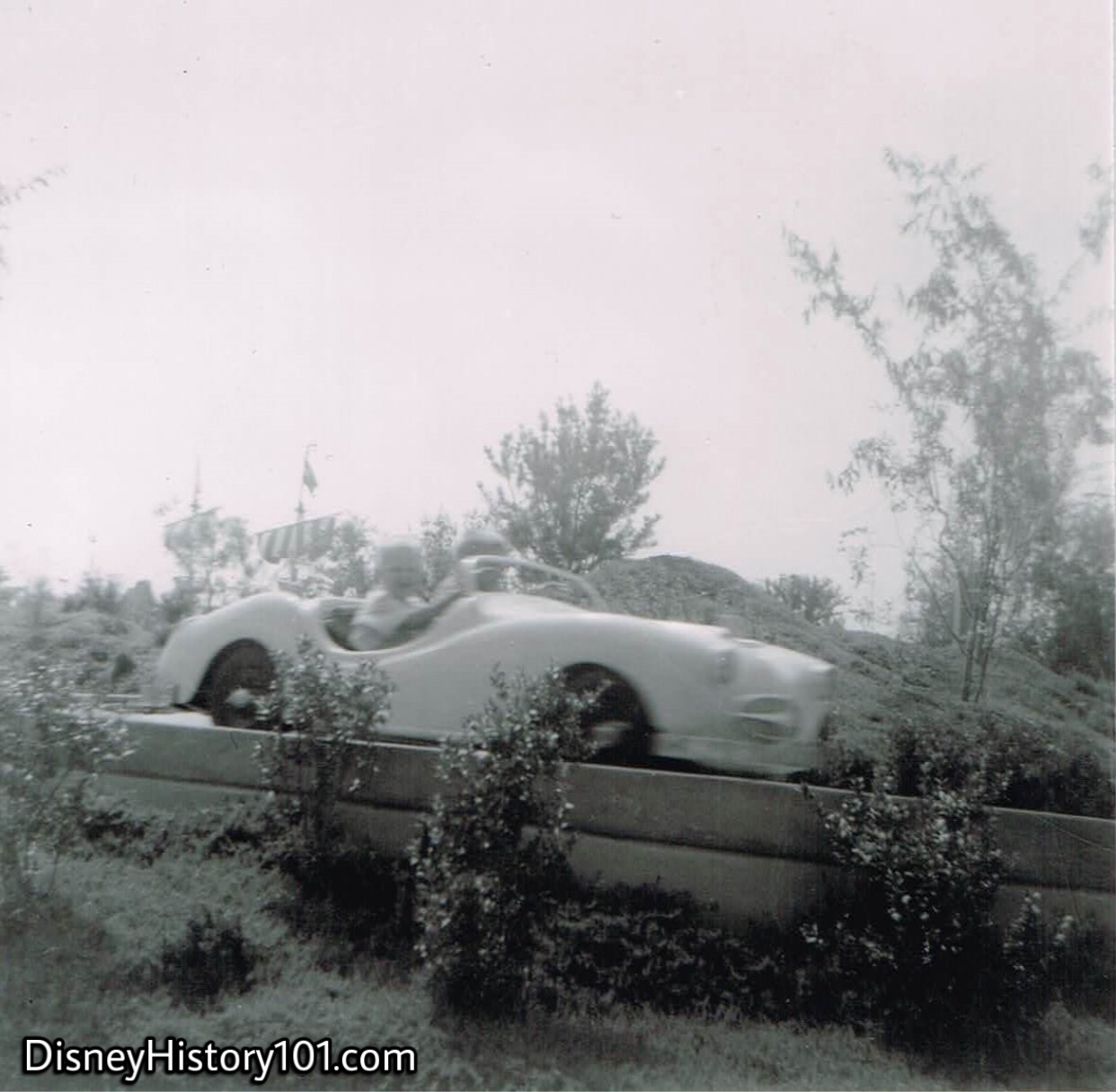
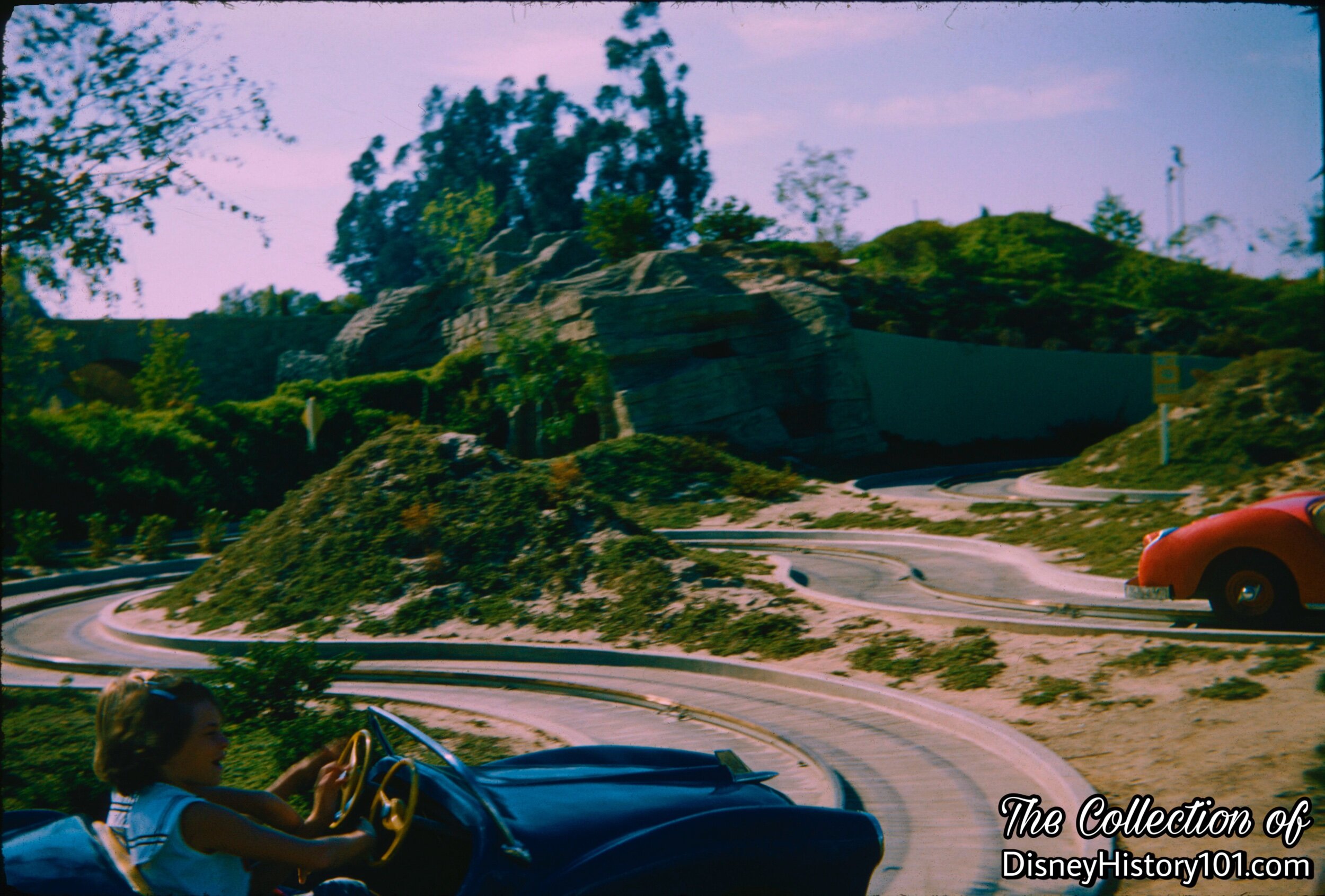
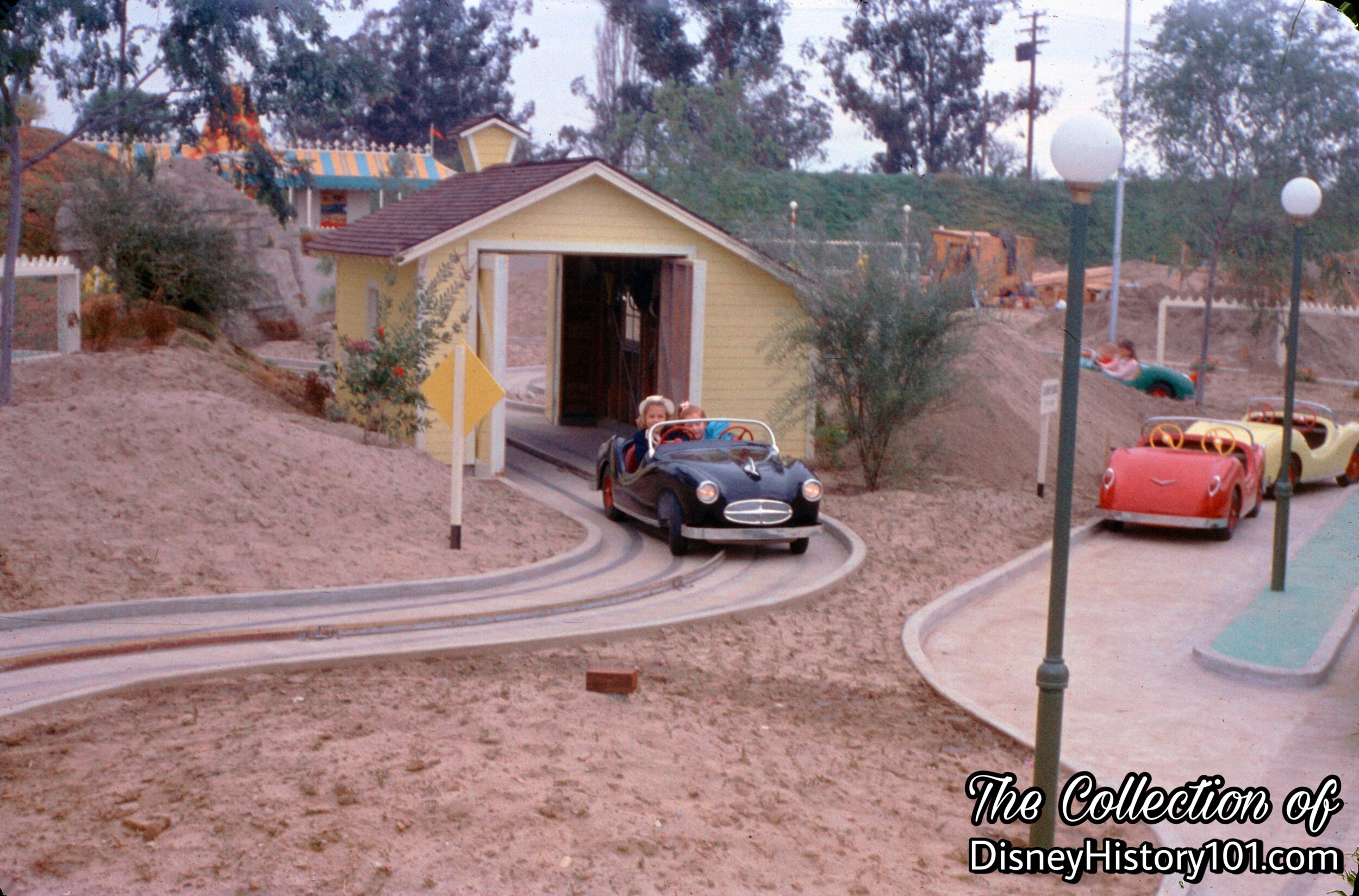
The former Walt Disney Imagineering Principal Creative Executive Marty Sklar would probably agree that the small details like these make the story appealing. One such detail was the garage. The memorable and climactic end of the Midget Autopia Show - crashing through a barn! This aspect of the attraction was even preserved on Souvenir Postcards during the Midget Autopia’s era of operation at Disneyland.
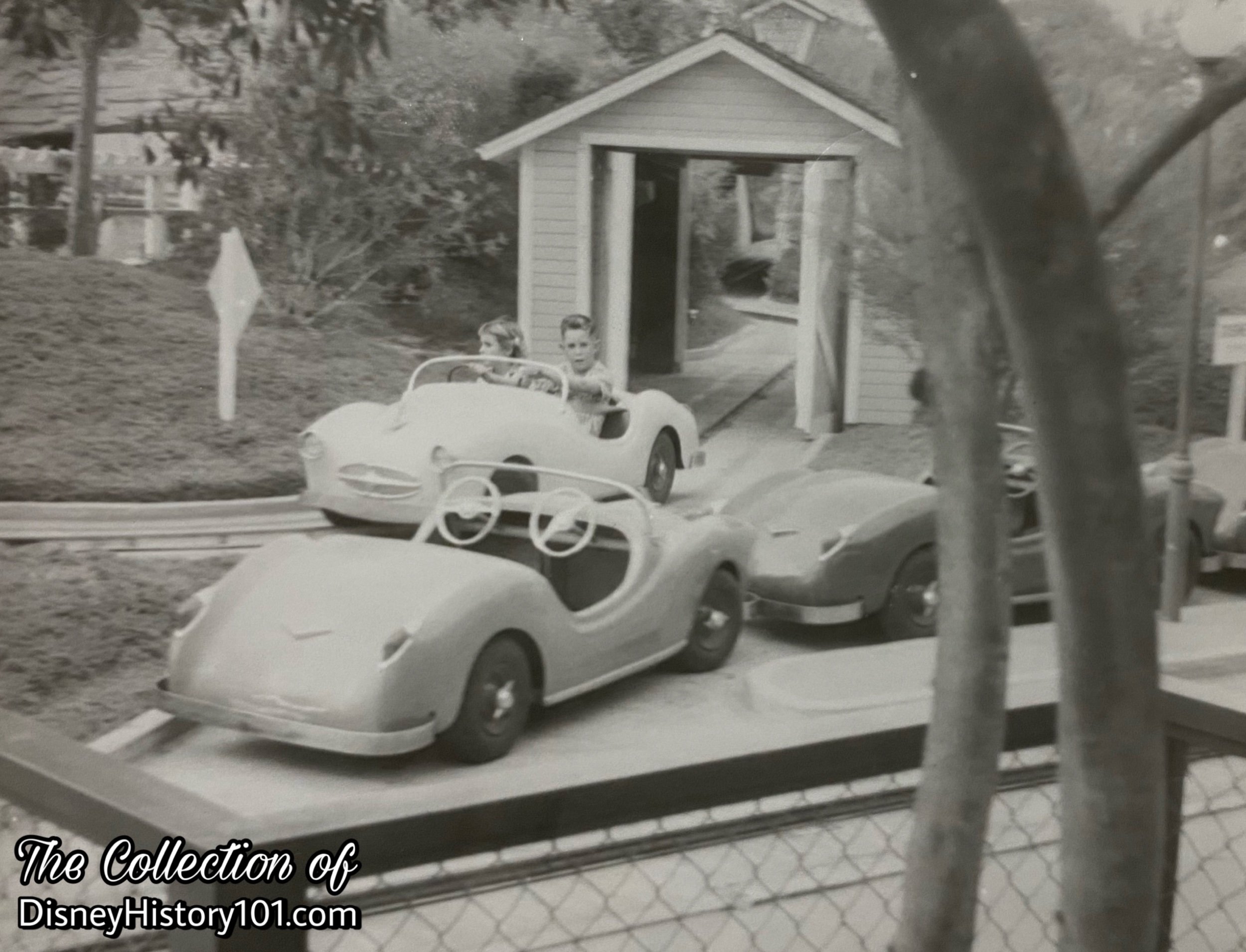
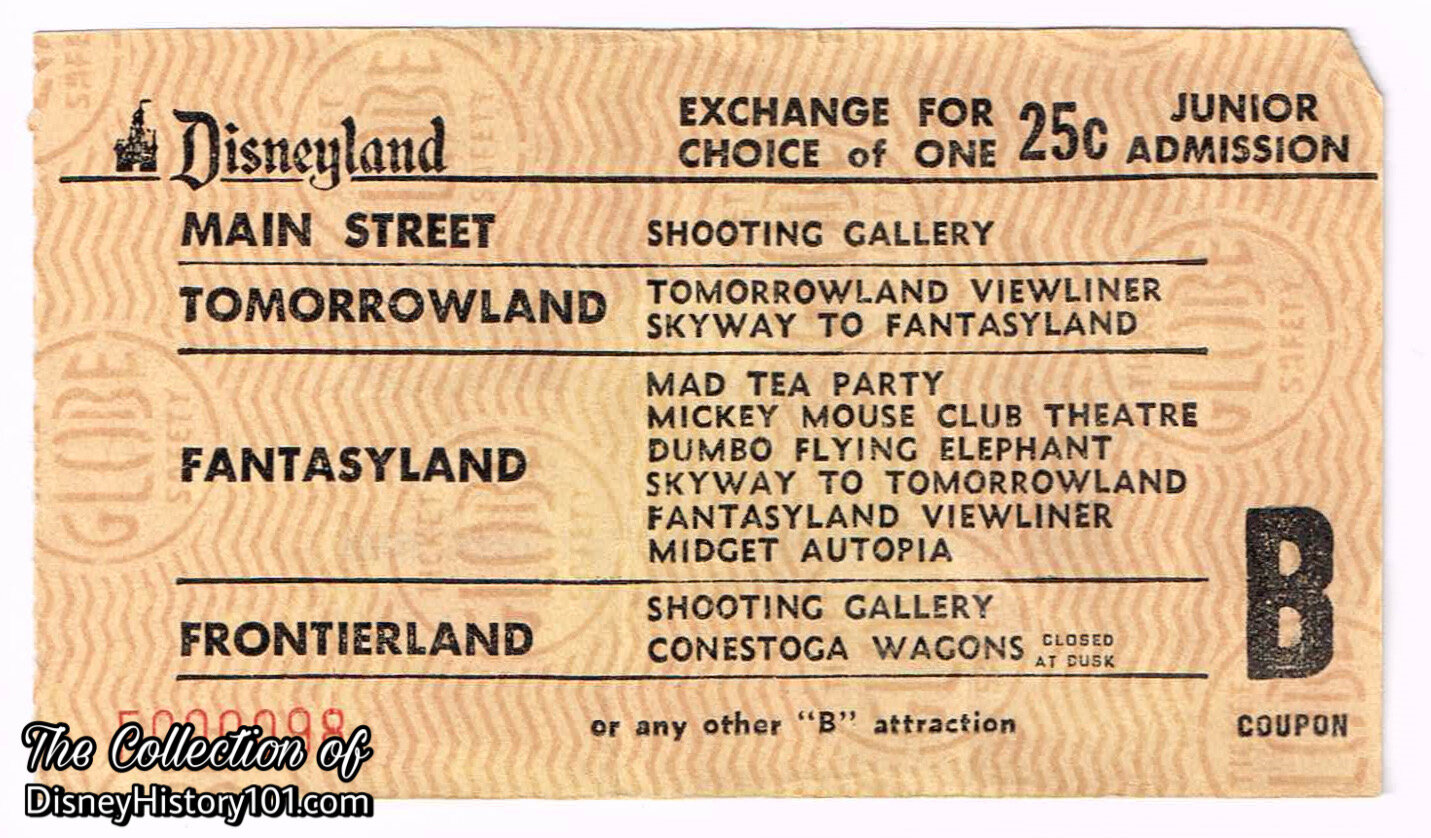
During 1957, admission for a ride aboard 1 of 10 Midget Autopia vehicles was one “jumbo” “B” coupon (or, 25 cents, for one adult), the same as a round of ammunition in the Main Street Shooting Gallery, entry into the Mickey Mouse Club Theater, or a ride aboard the Fantasyland or Tomorrowland & Fantasyland Viewliner! Based on the response of guests who recollect riding the Midget Autopia, it was well worth the price of admission!
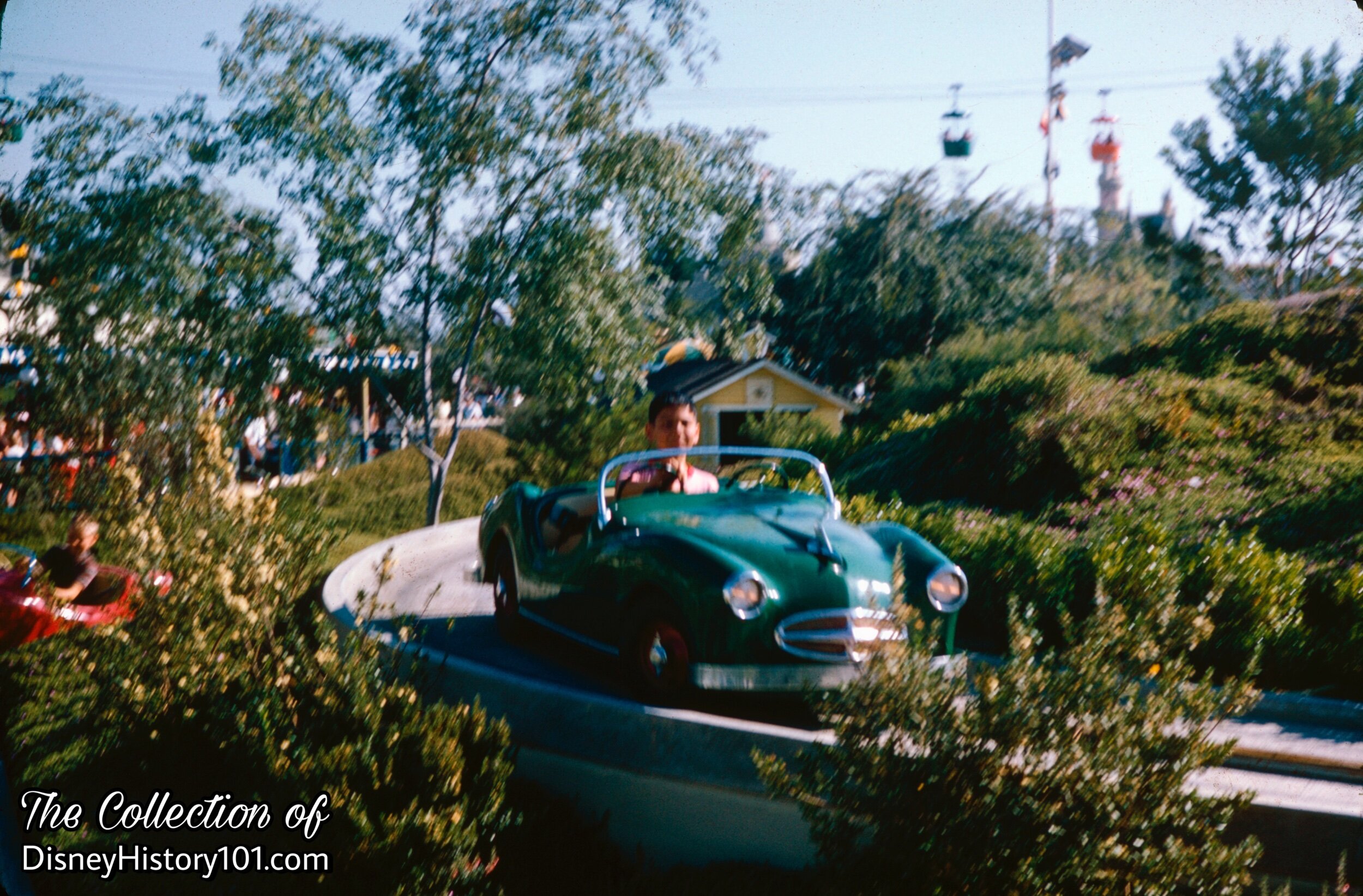
By 1959, Joe Fowler was Vice President of Disneyland Operations Committee and Doc Lemmon of Disneyland Operations was overseeing Operators of Rides & Amusements (like the Midget Autopia), Livestock, Parking Lot, and Ticket Sellers. Quite a few memorable Disneylanders operated the Midget Autopia (like Earl Roy Archer), “who had a wonderful way with kids,” according to Backstage Disneyland (Summer, 1965). Roy Brem also operated the Midget Autopia.
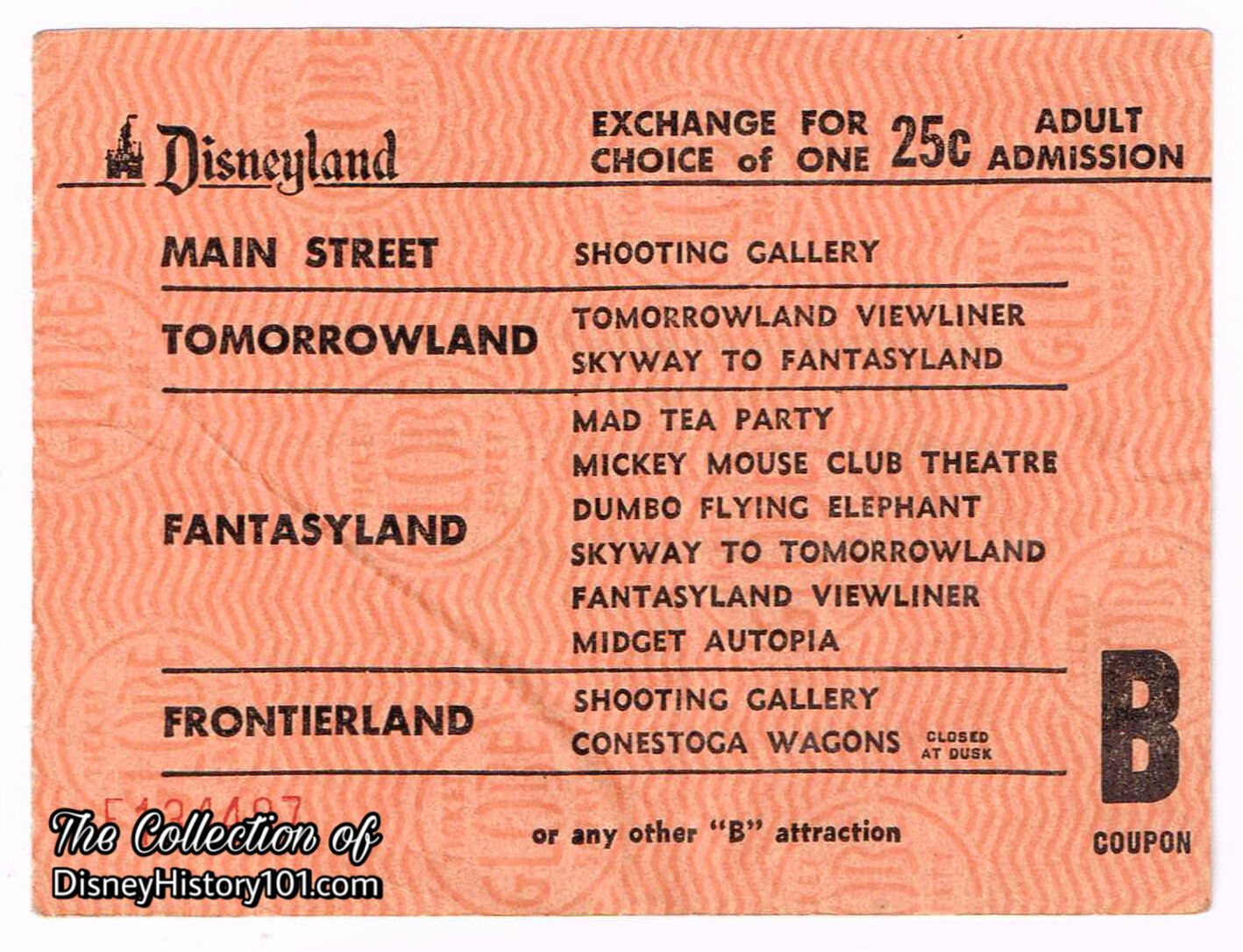
Contrary to rumors, guests of all ages were allowed aboard Midget Autopia vehicles (depending on their height and weight). Yes, if they met the height requirement and did not exceed the weight limit, Adult Disneyland guests could exchange the corresponding admission coupon for a ride! Just look at the following “Vintage View”!
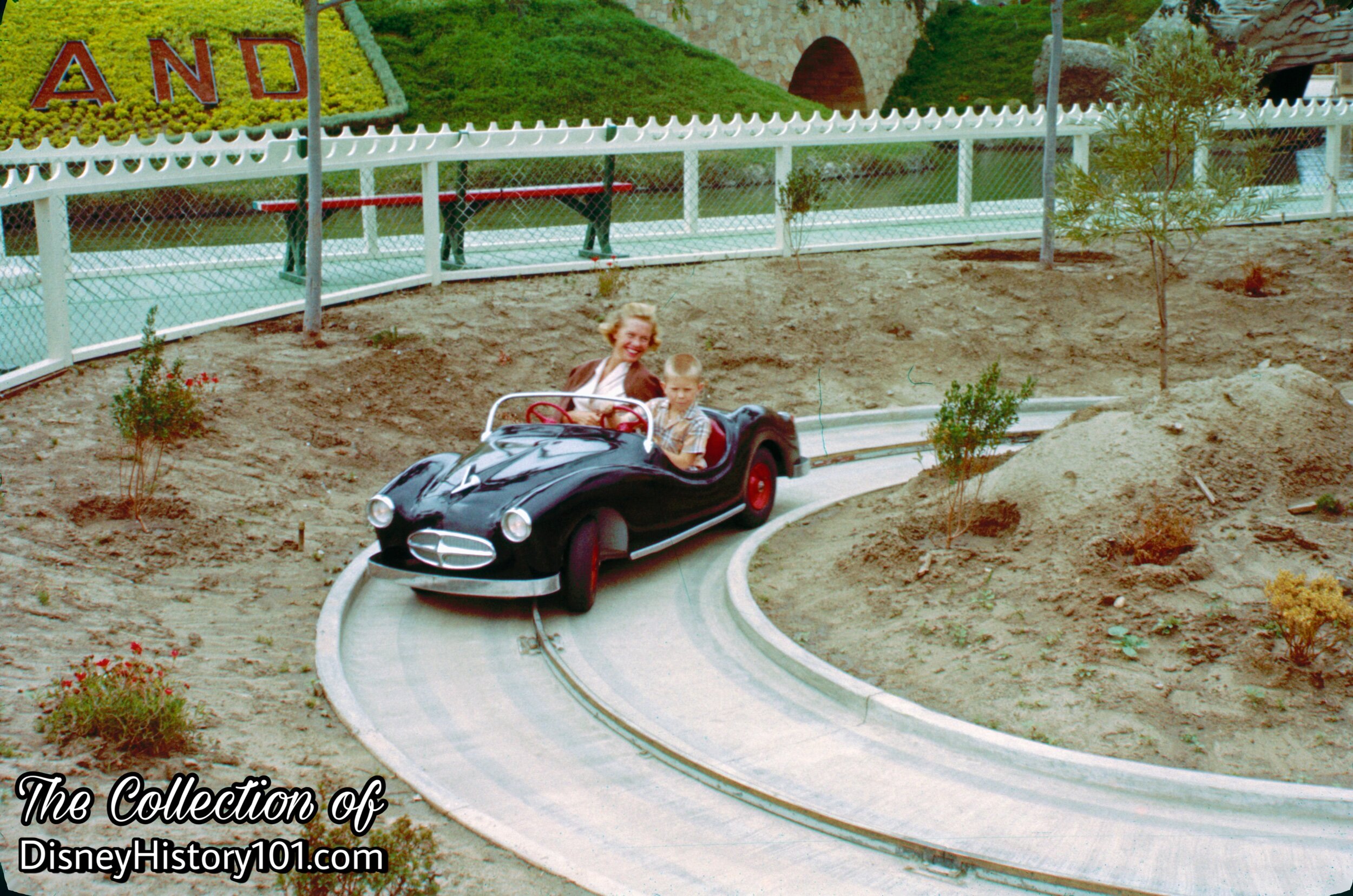
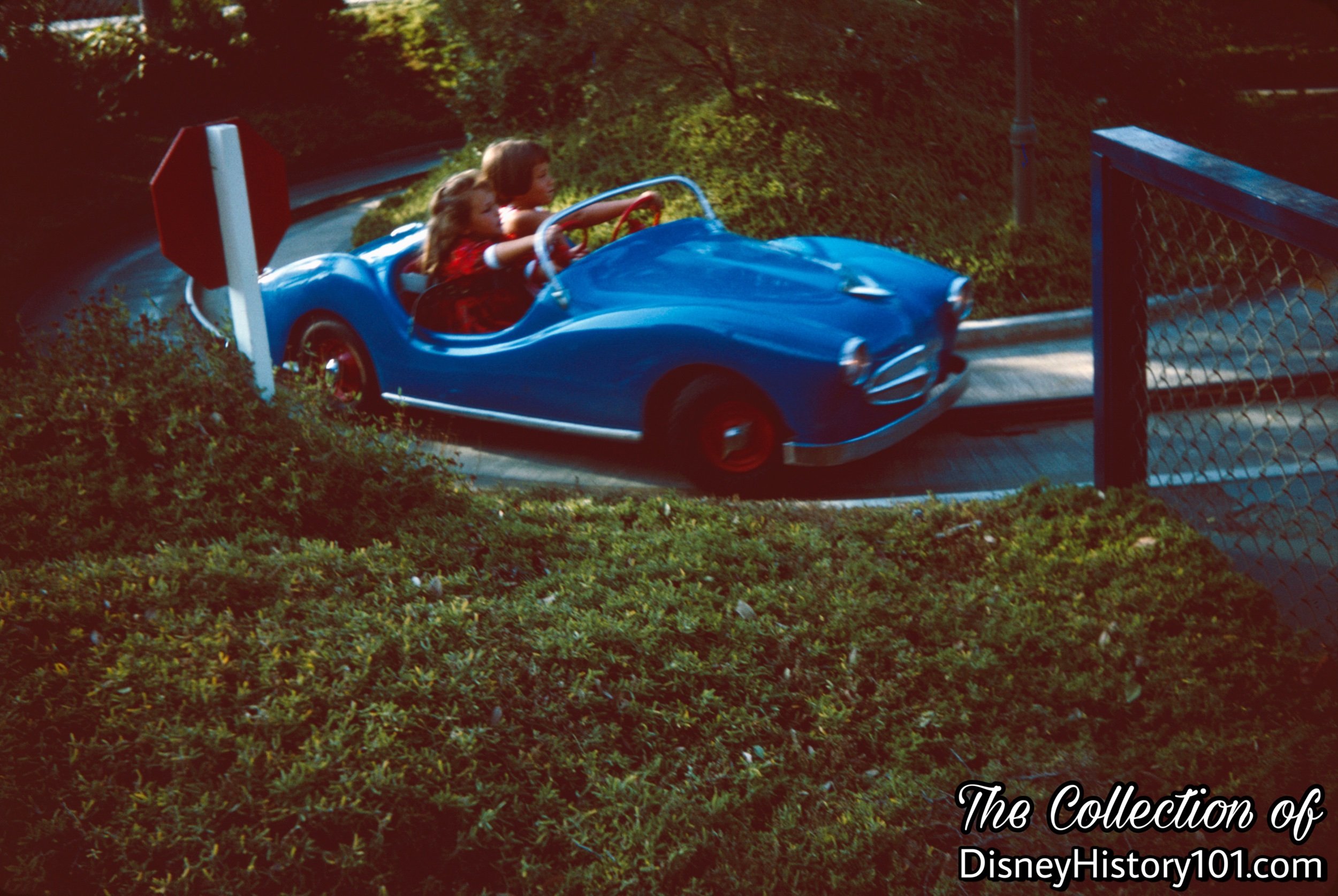
The Midget Autopia was closed weekdays during the winter season of 1962, operating only on weekends.
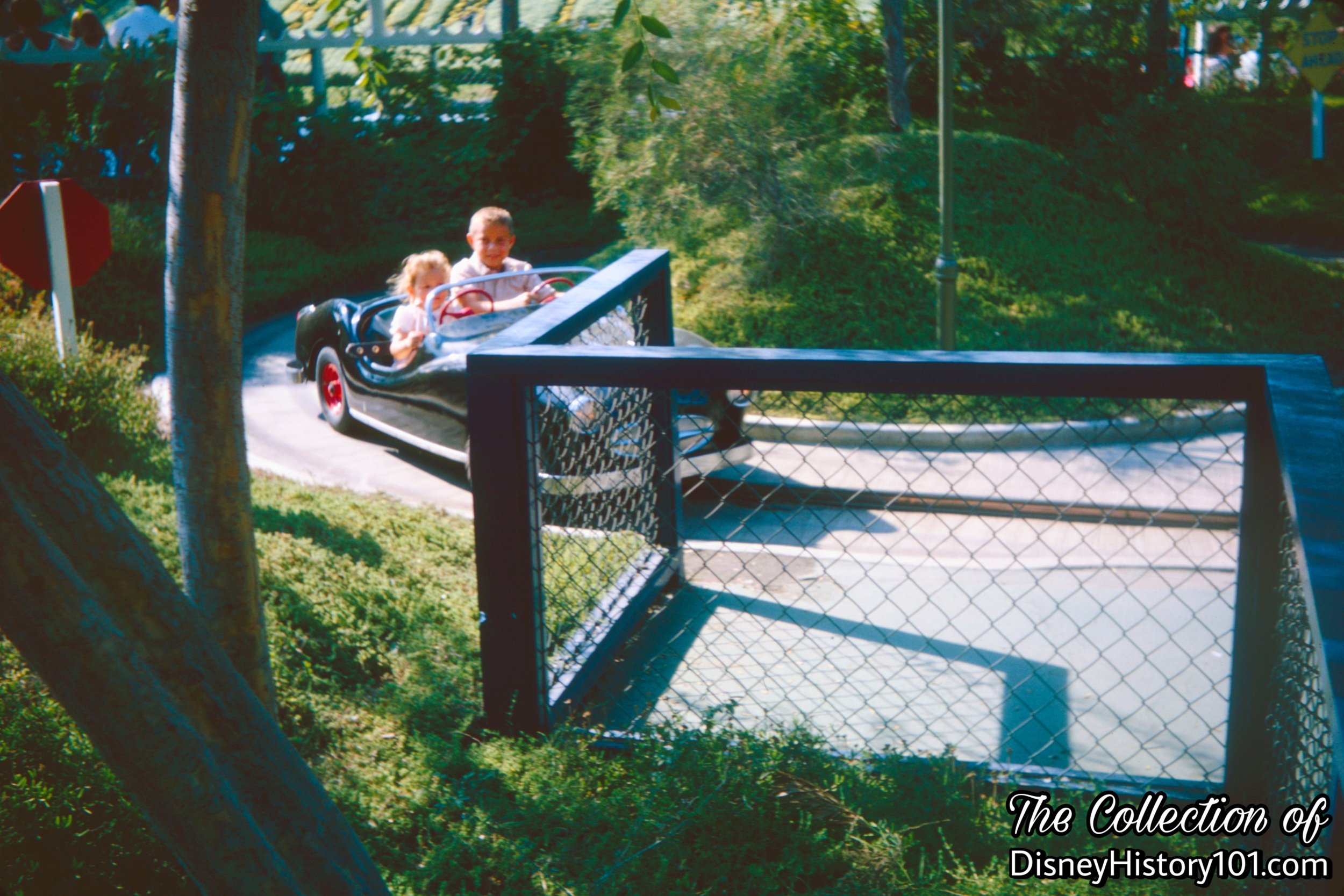
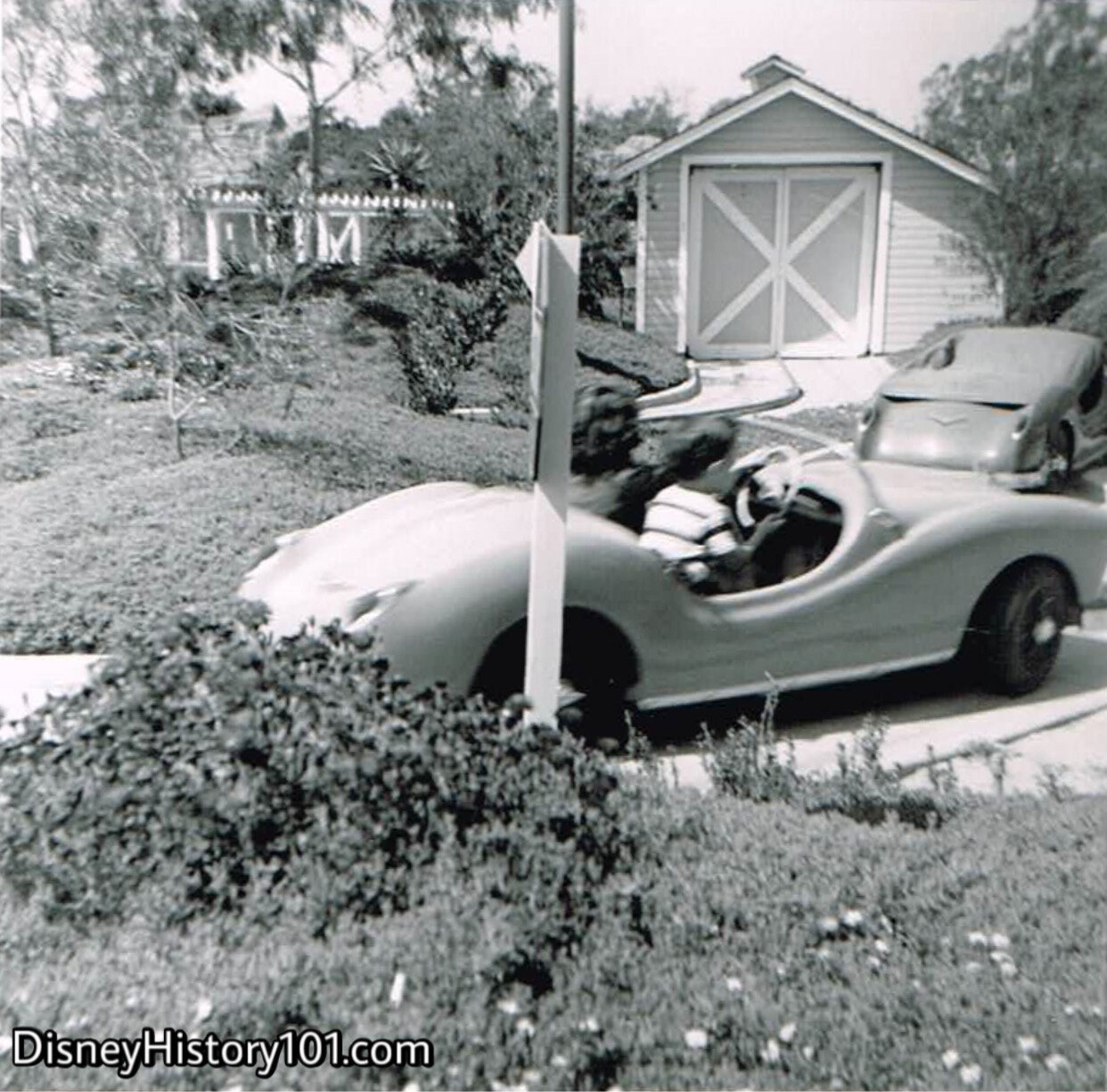
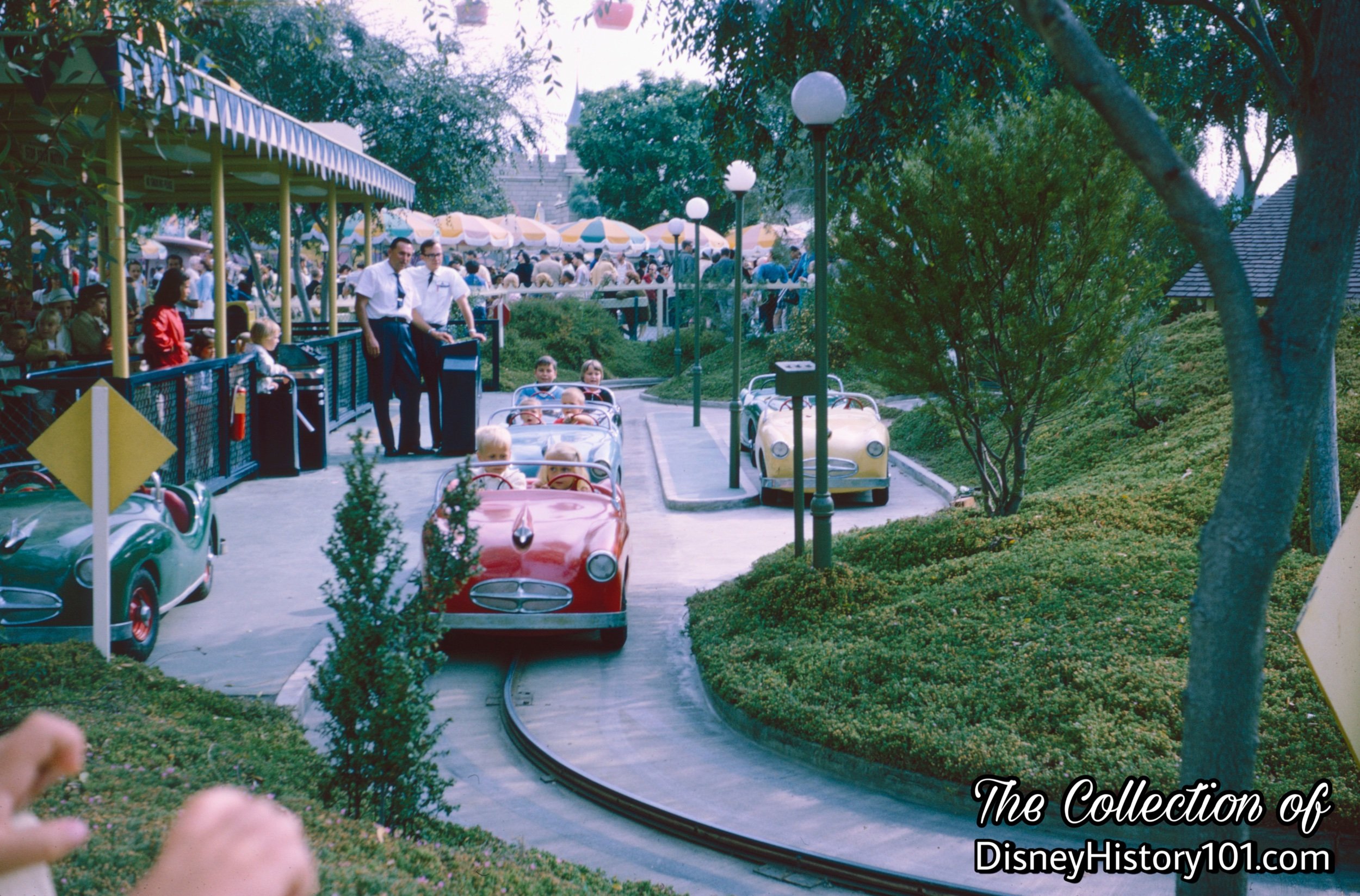
Many notable Disneylanders had a privileged part in the Midget Autopia rotation - the set order of Midget Control panel operating positions established by the attraction's Working Lead.
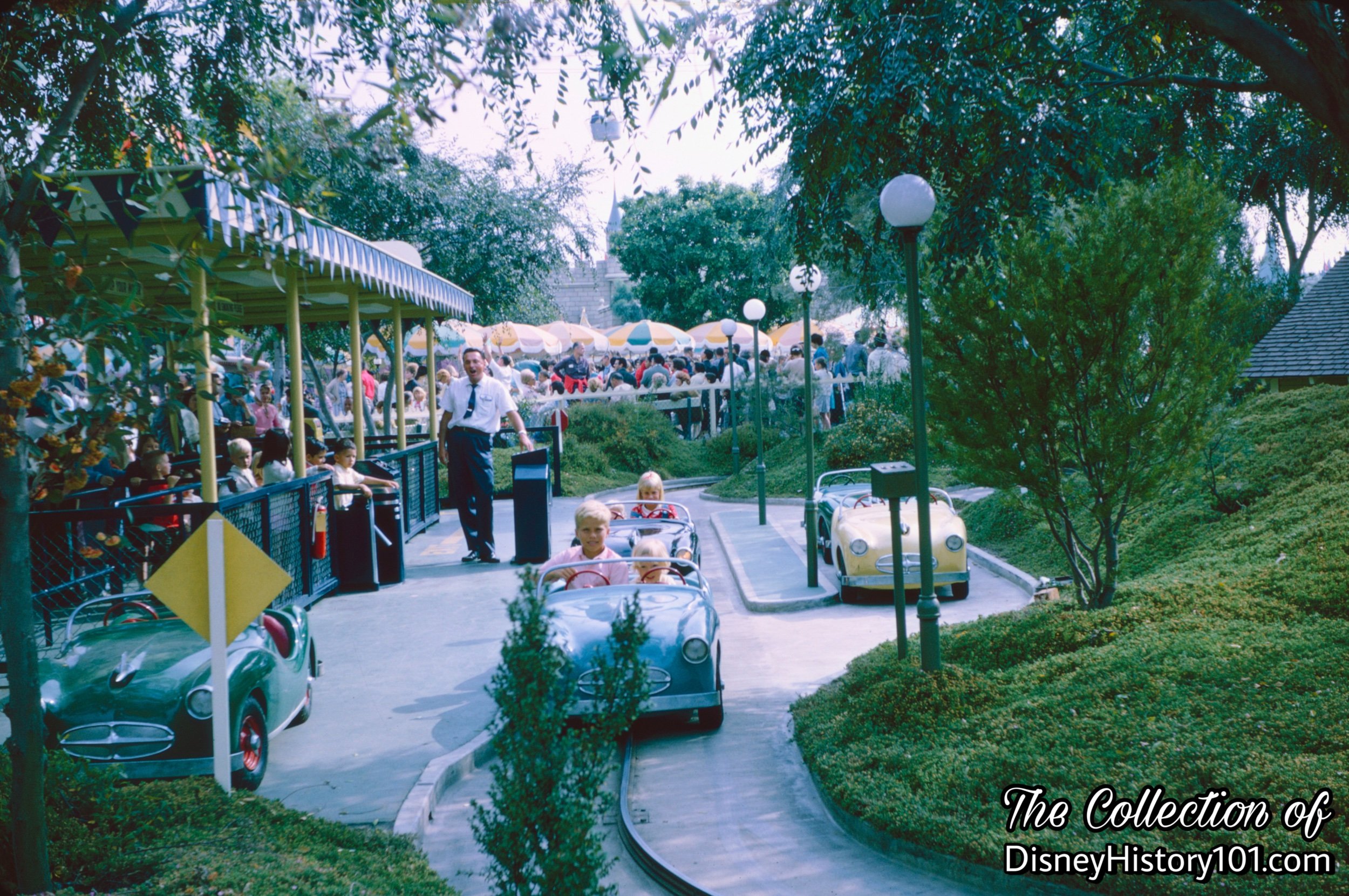
The Midget Autopia was still as popular than ever during its final year of operation at Disneyland. According to Mike O’Brien of Backstage Disneyland (Vol.4, No.4 ; December 1965) :
“Ron Osbon is the Man on Midgets. In fact, you could call him Mr, Midgets. He, as well as your scribe, will mourn the passing of Midget Autopia to a never-never land somewhere over the rainbow. The sheer delight of the little kiddies when they get behind that wheel is something to behold. Just recently, Ron was operating the ride when he looked up and saw Walt Disney waiting in line with his grandchildren. Ron invited him to come in the back way, but Walt said no, that he would wait in line like the other people. He expressed the fondness that he and his grand-kiddies have for Midget Autopia and said that he would like to see it relocated and remodeled in another area.” This is reminiscent of something else that Walt once said : “Disneyland is like a piece of clay : if there is something I don’t like, I’m not stuck with it. I can reshape and revamp.” And a fantastic example is the Midget Autopia once located in this little section of Fantasyland.
At a Walt Disney Productions Stockholders meeting (held on February 1, 1966), “Mr. Tatum pointed out - 50% of all visitors to Disneyland return later to see the Park’s new attractions.” Next, a need for an increased capacity was stressed, by “more facilities - rides, attractions, food and merchandising, to handle properly and efficiently our ever increasing guests.” And so, the Midget Autopia would yield to progress and efficiency, and make way for fantastic new Disneyland adventures by Imagineers who knew their audience!
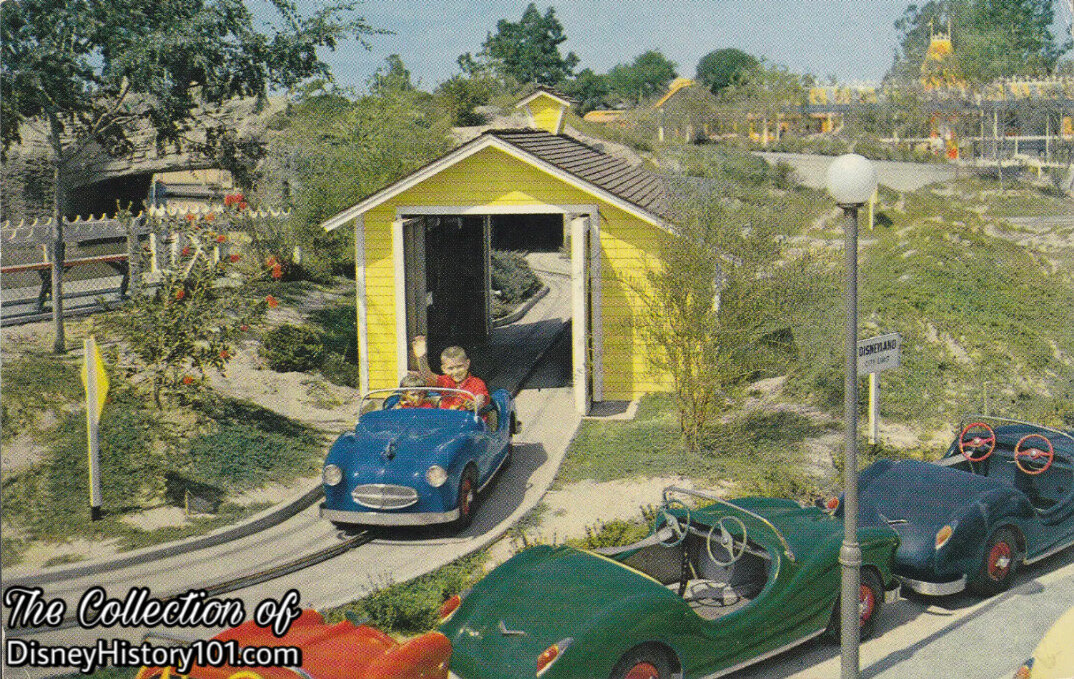
According to one Disneyland Admission Media Rides and Attractions Report [prepared in April 1971, by Disneyland Research Department], by the time the Midget Autopia ceased operation in Disneyland, a grand total of 2,461,589 Disneyland guests (like Walt and his grandchildren) had sat behind the wheels of a Midget Autopia roadster. Though the smallest of the Autopia tracks was eventually removed to widen the pathways for the installation of it’s a small world, it wasn’t the end of the road for this Disneyland adventure!
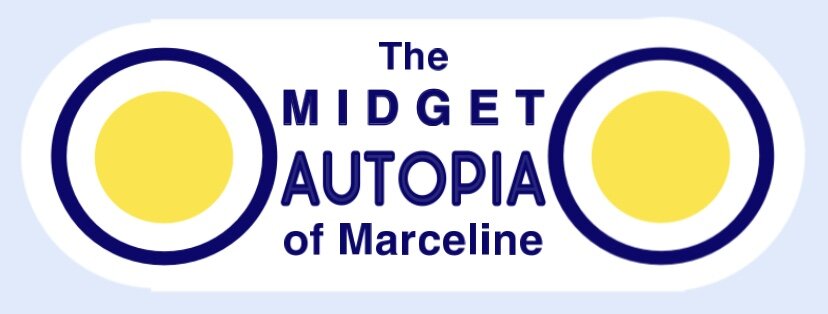
So while many other parks (around North and South America) had an Arrow-Flite Tracked Auto Ride, the most famous of them all - the Midget Autopia -would soon find new life in Walt Disney’s hometown of Marceline, Missouri. The Midget Autopia would hold the record as the only Disneyland attraction to ever be donated and relocated outside a Disney Park, by Walt Disney! Please step this way, as we understand how this happened, courtesy of artifacts preserved through The Walt Disney Hometown Museum of Marceline, Missouri.
As early as 1961, Walt (through private communications with his friend Rush Johnson) furthered his intentions to give the Disneyland Midget Autopia attraction to the children of his beloved hometown. By offering drawings and photographs of the Fantasyland attraction to the Marceline City Council members, Walt hoped to give them a better understanding of what the gift would look like.
Admiral Joe Fowler was sent to Marceline for the installation of the attraction.
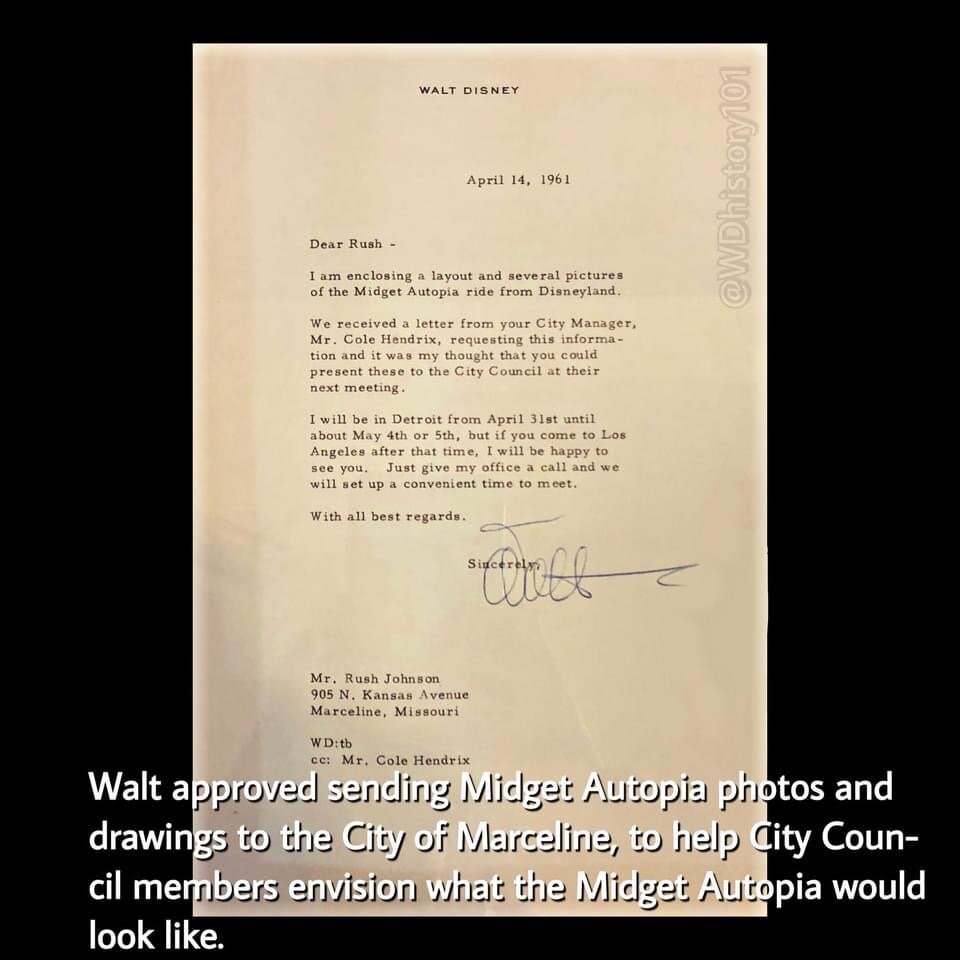
Over the next four years, plans would be made official, with the following press release from WED Imagineering! A WED Imagineering memo stated: “Donation of this ride is unprecedented in Disneyland's historv and will probably be the only one ever taken to a new location from the us Magic Kingdom in Anaheim, California.” The Midget Autopia would relocate to Marceline, Missouri, and a festive dedication was scheduled to take place on July 4th, 1966.
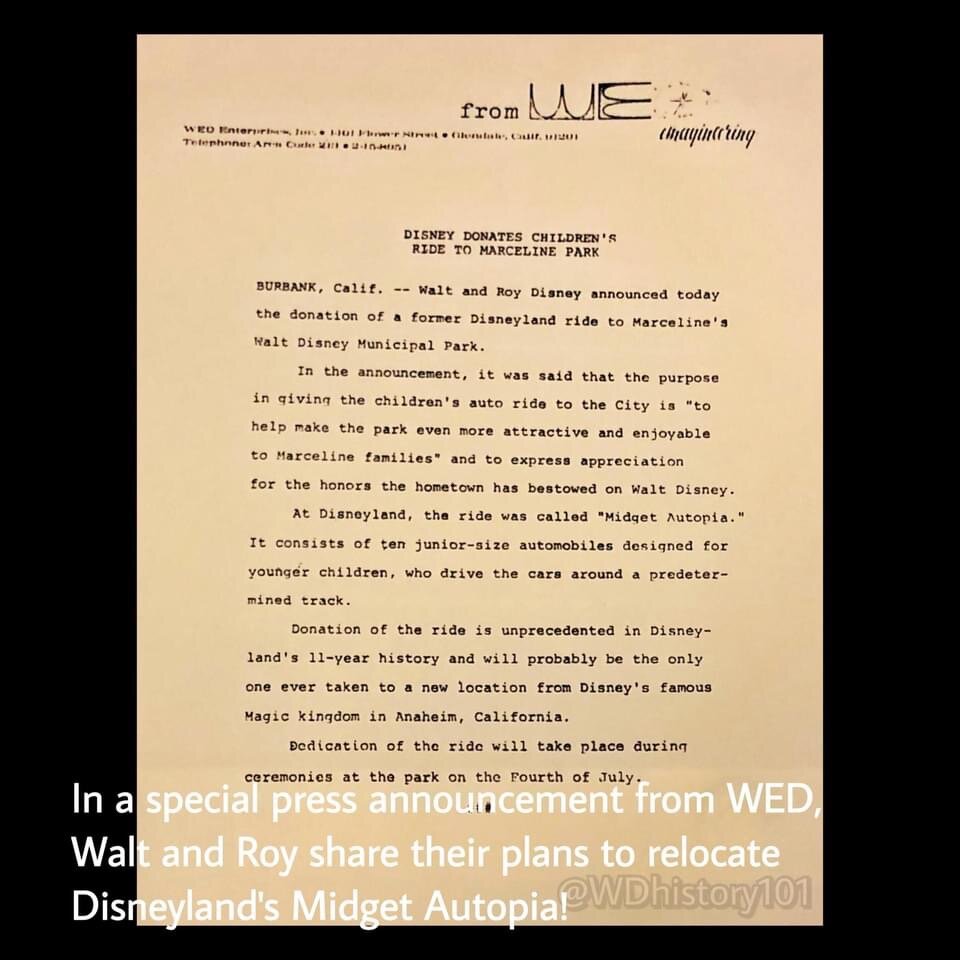
During 1966, workers finished adapting the Disneyland Midget Autopia Track layout for the town of Marceline, in preparation for the arrival of the rails, cars, and other attraction parts!
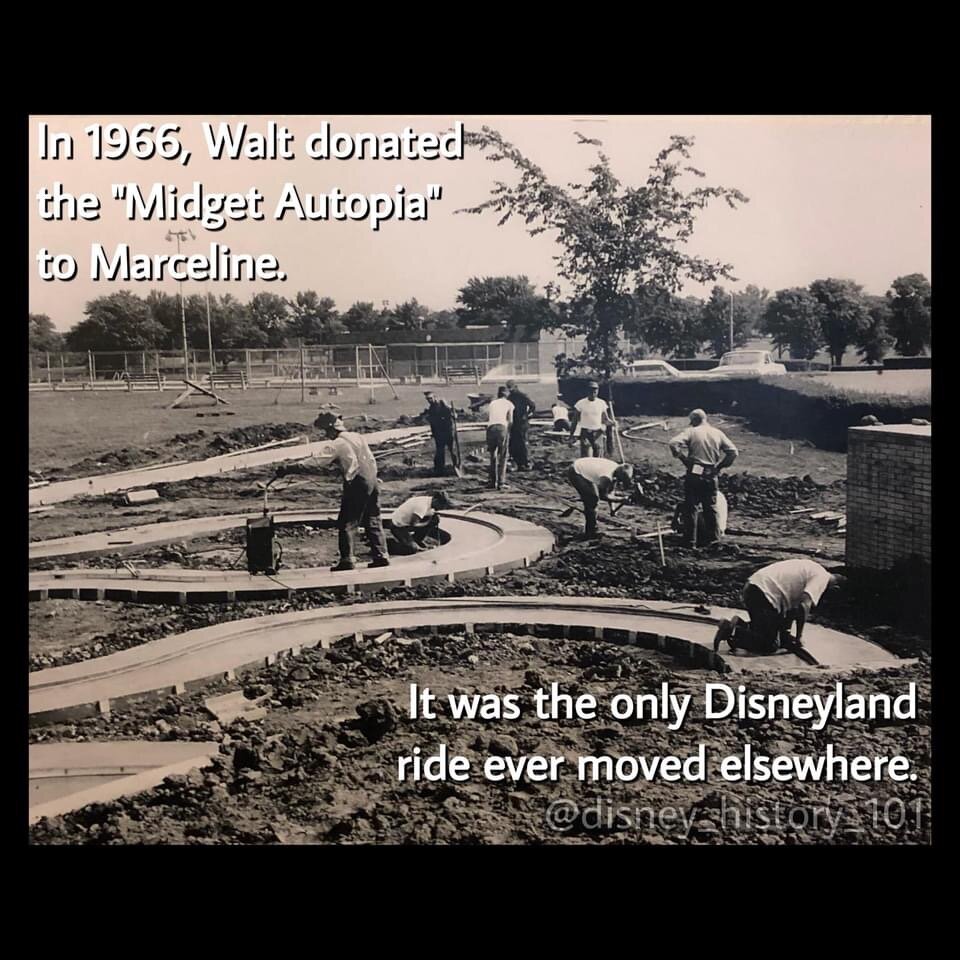
The big day arrived! The entire town of Marceline awaited the special pre-recorded Dedication Speech spoken by Walt Disney!
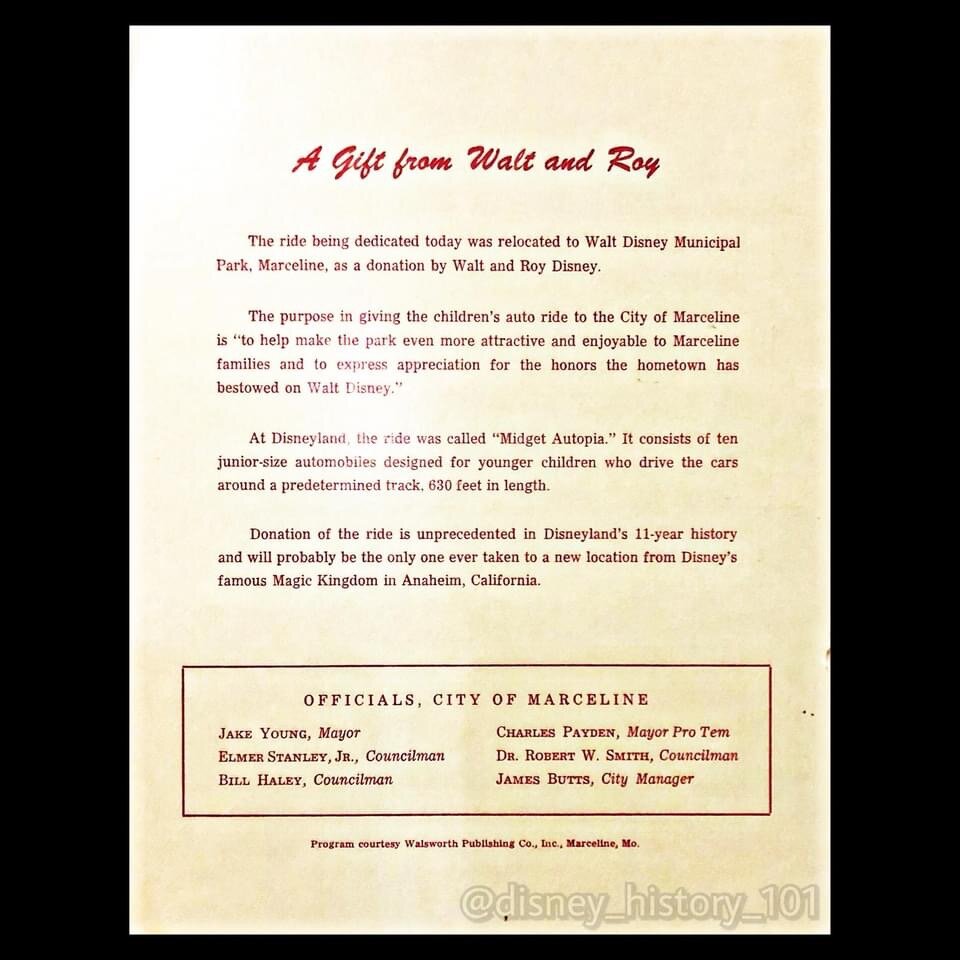
The following program facsimile gives an idea of the scheduled events planned for the Grand Opening Dedication Ceremony of Walt Disney Municipal Park. Festivities would include a beauty pageant (in which future Walt Disney Hometown Museum Director Kaye Malins would participate). A ribbon-cutting ceremony also occurred after a brief history of The Midget Autopia was recounted.
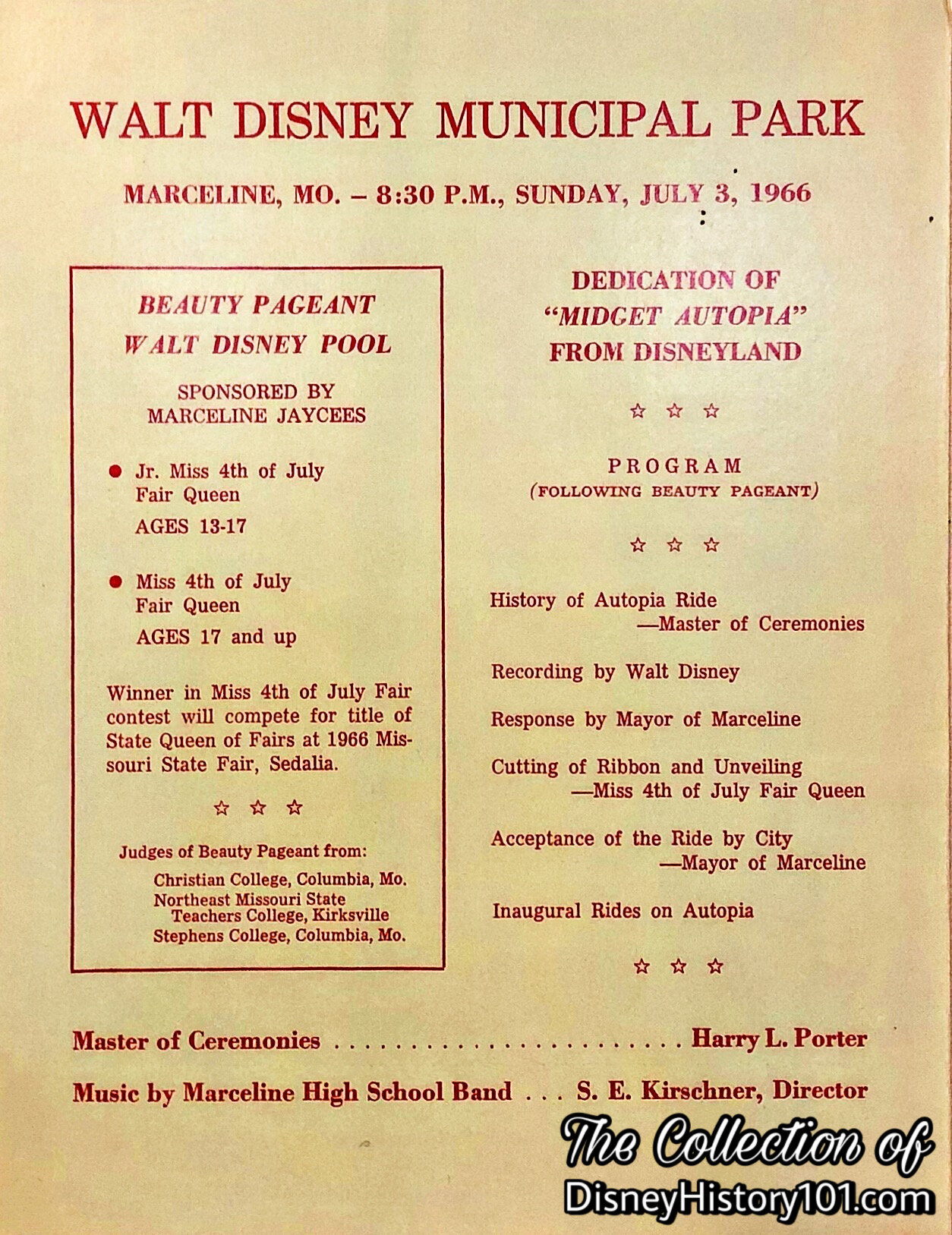
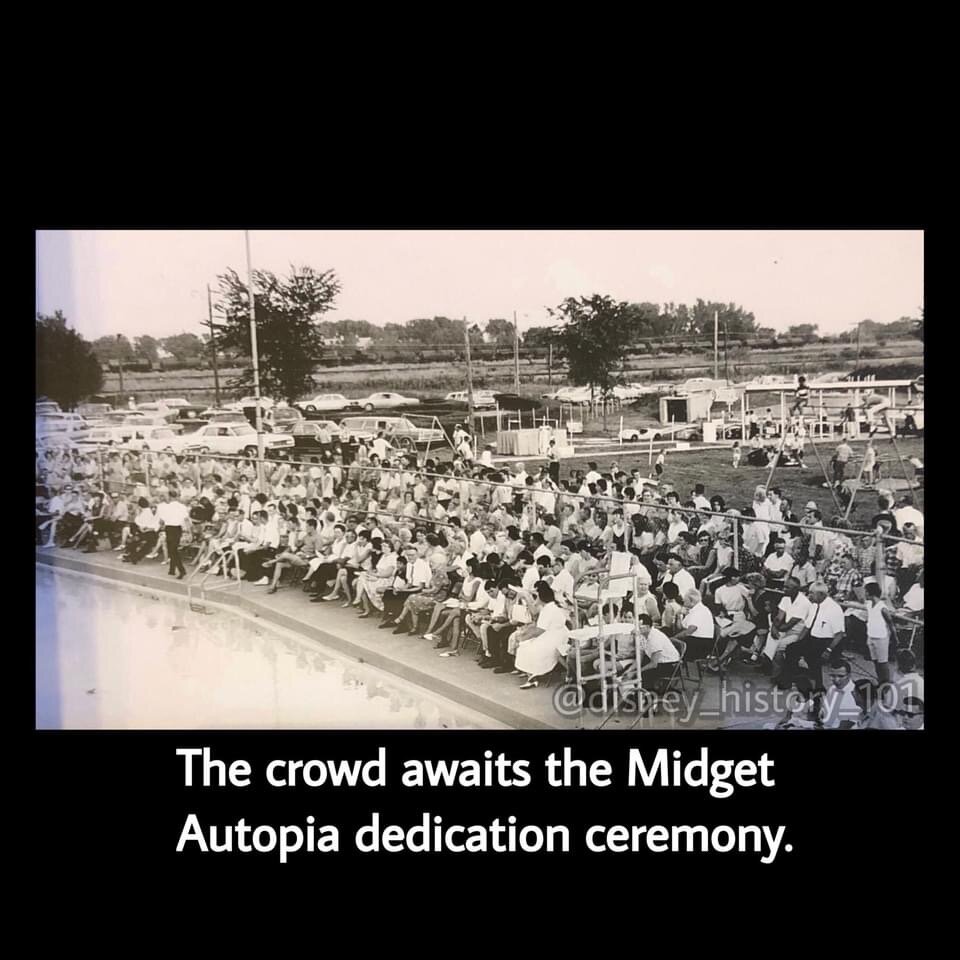
Walt wanted to dedicate his gift in person, but was forced to cancel his trip just a few days prior due to a cough he “couldn’t shake”. It later turned out to be cancer. Instead, his dedication speech was recorded and forwarded to Marceline in time for the ceremony. As you read Walt’s words, note his blessing upon the people of the small town, the children, and the Midget Autopia attraction itself!
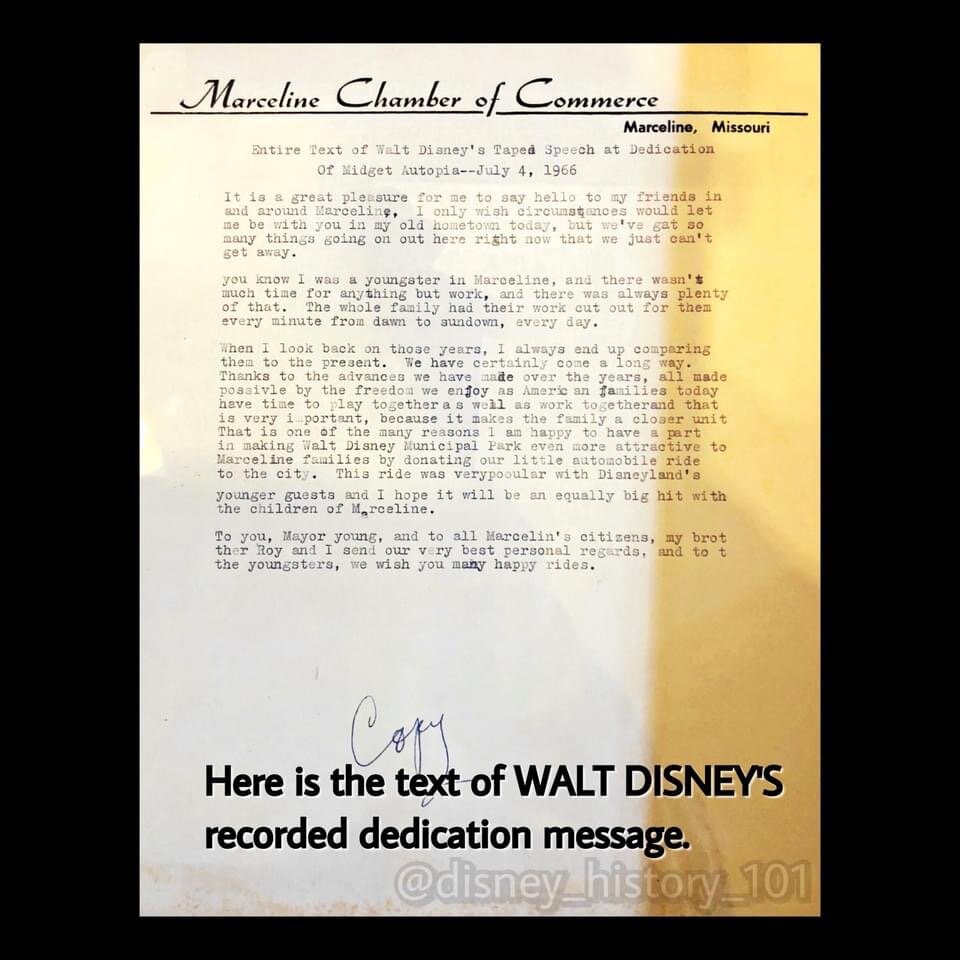
During (and after) the Dedication Ceremony, the children of Marceline await the Grand Opening!
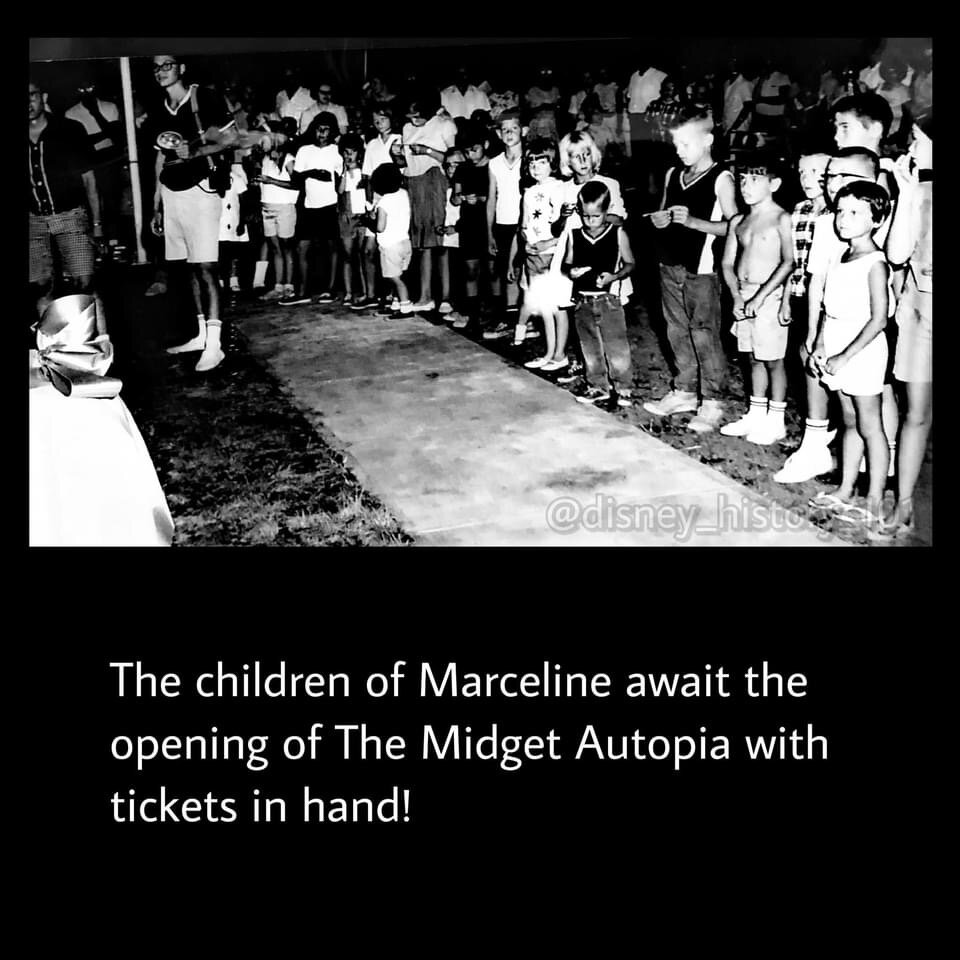
A few lucky children of Marceline take a spin around the curves of Walt’s “little” gift!
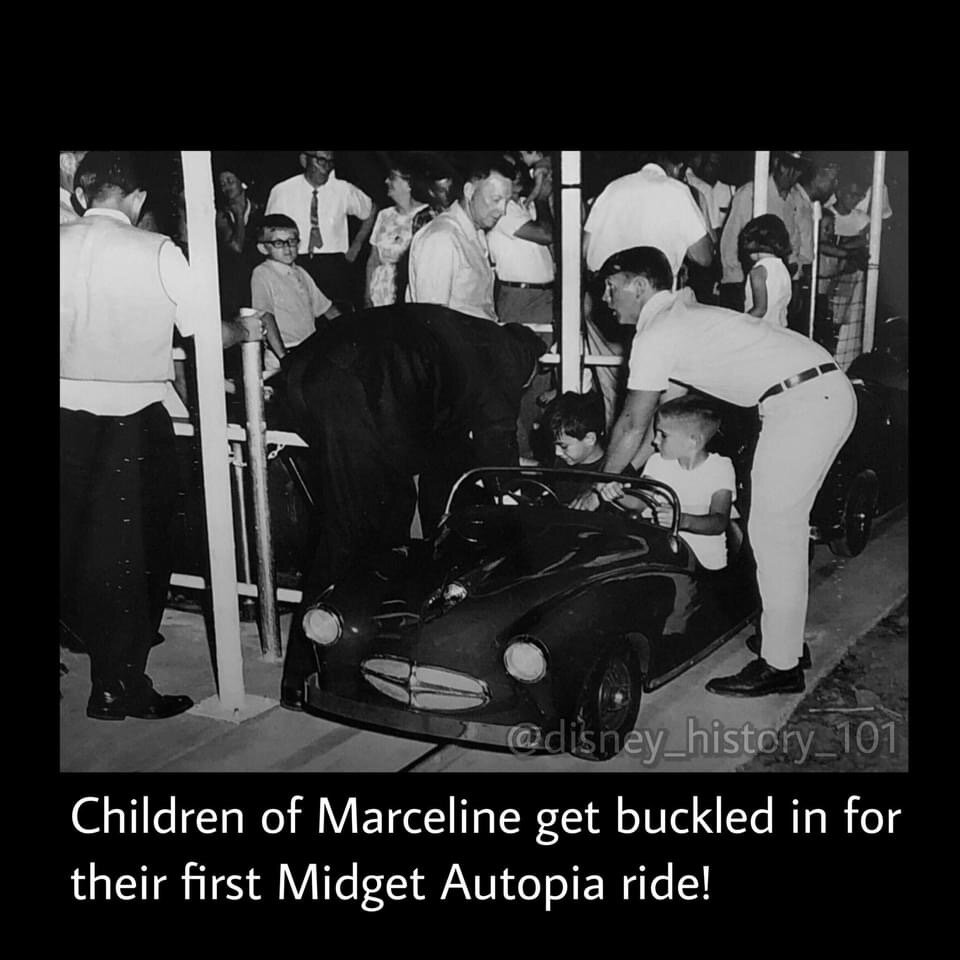
The Governor of Missouri praised the new state attraction, and congratulated Marceline’s Mayor Young and the Citizens of Marceline!
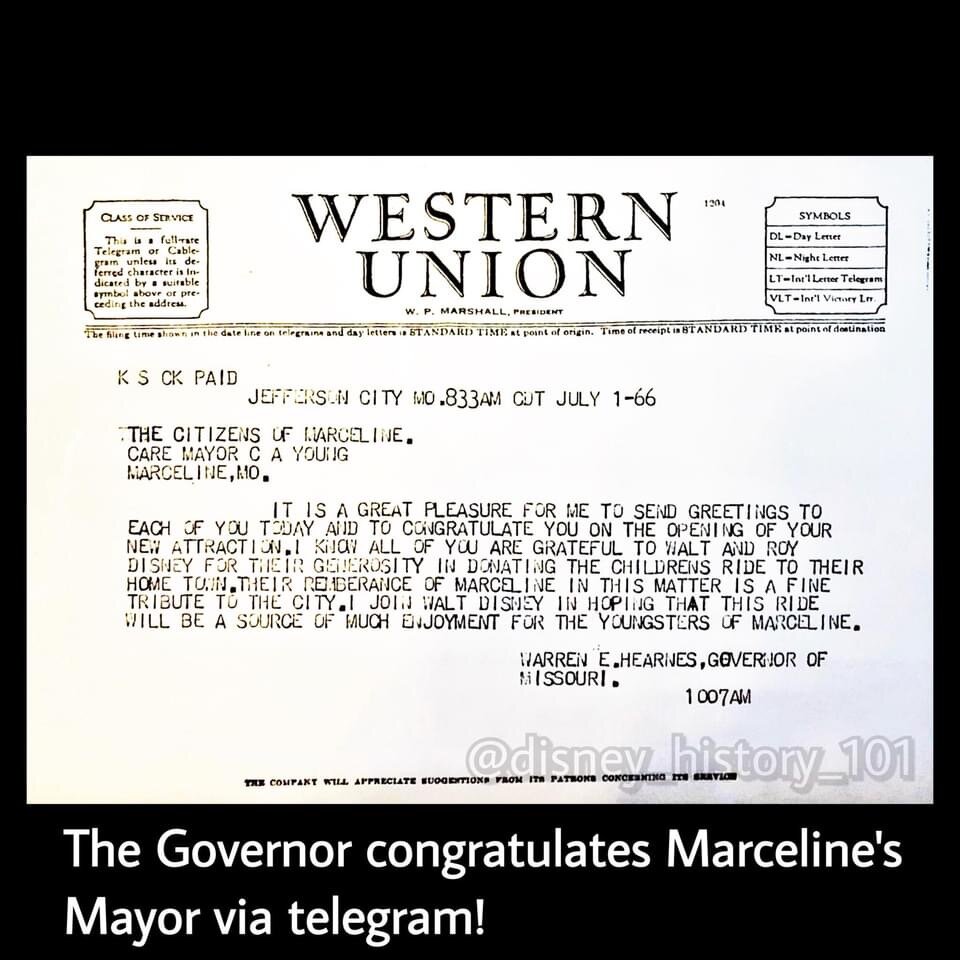
Photographs and accounts surrounding the dedication of Walt Disney Municipal Park and its main attraction (The Midget Autopia) were sent to Walt, so he could share in the joy of the festivities. Walt appreciated this gesture so much that he thanked the Mayor by writing this letter dated July 22, 1966. The attraction operated a year longer in Marceline than it operated at Disneyland.
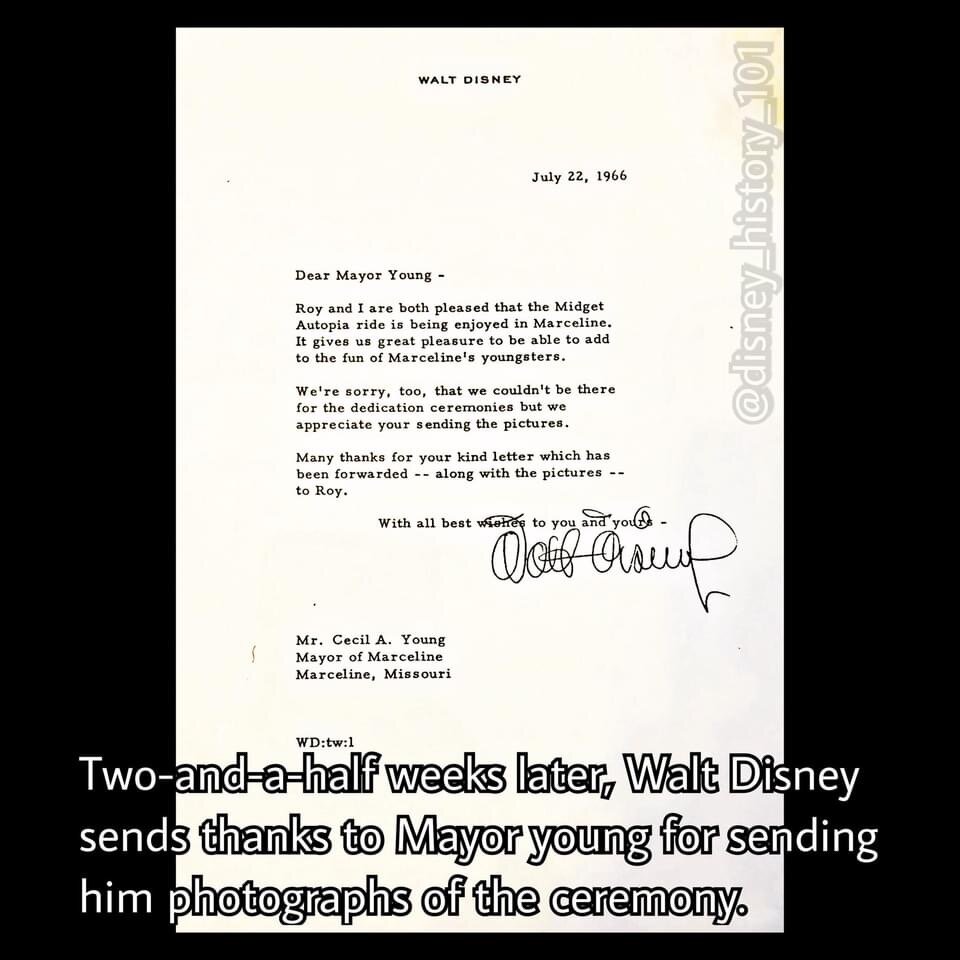
If you visit the site today, you may notice a plaque near the former location of the Midget Autopia track commemorating Walt’s historic gesture this way :
”Relocated from the Magic Kingdom of Disneyland as a gift to the children of this community from Marceline’s favorite sons Walt and Roy Disney. Accepted in appreciation July 1966, Mayor C.A. Young”
Walt passed on December of 1966. The Midget Autopia continued operation for 11 years.
“Once located in Marceline's Walt Disney Municipal Park, the beloved ride was operational from 1966 through 1977. When the city retired Walt and Roy's gift from day to day operation the concrete track remained as a playground for local children, and a visual reminder of the Disneys' generosity. Sadly the 1966 track was removed from its park location by the City of Marceline due to maintenance and safety concerns.”
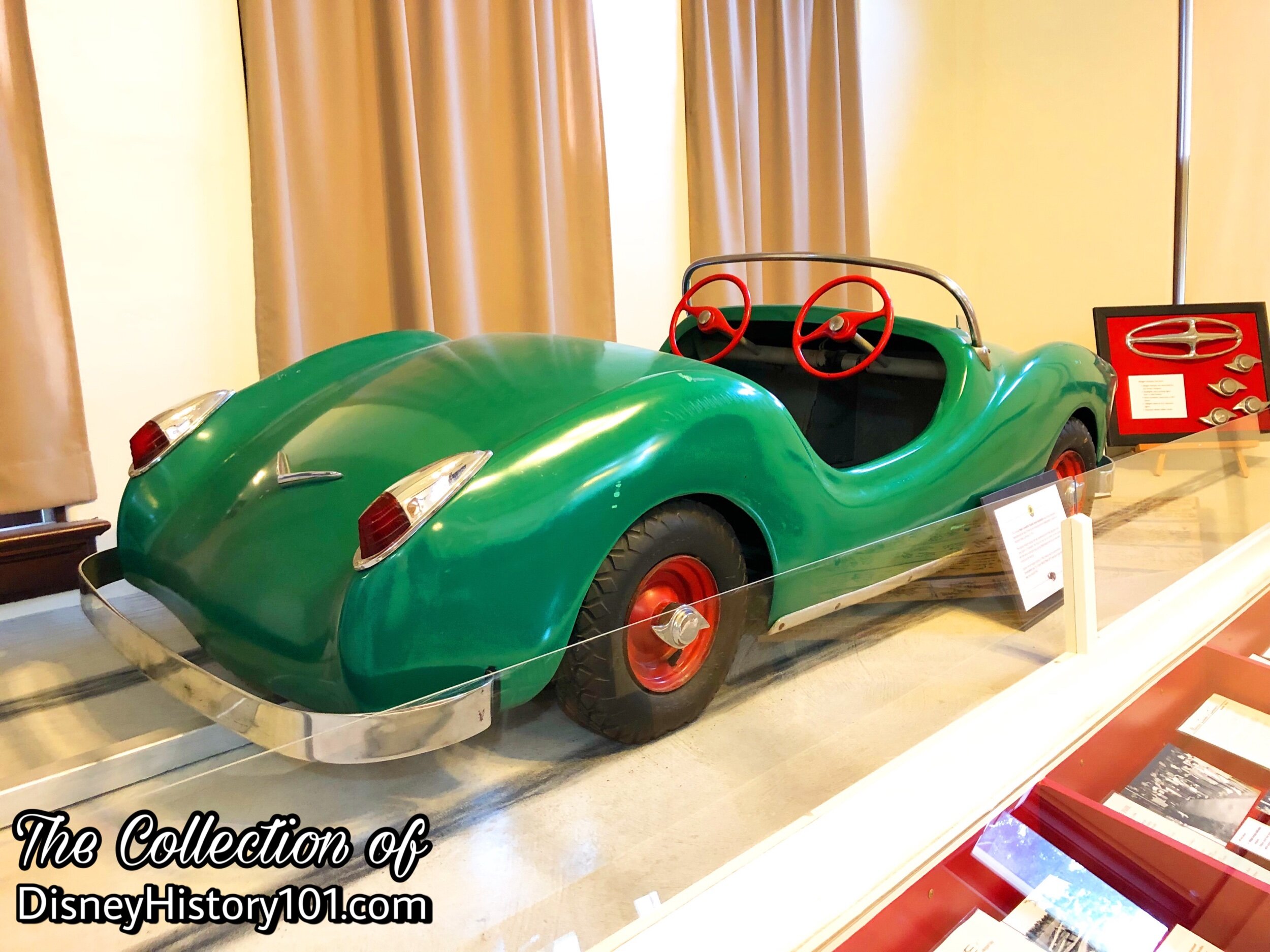
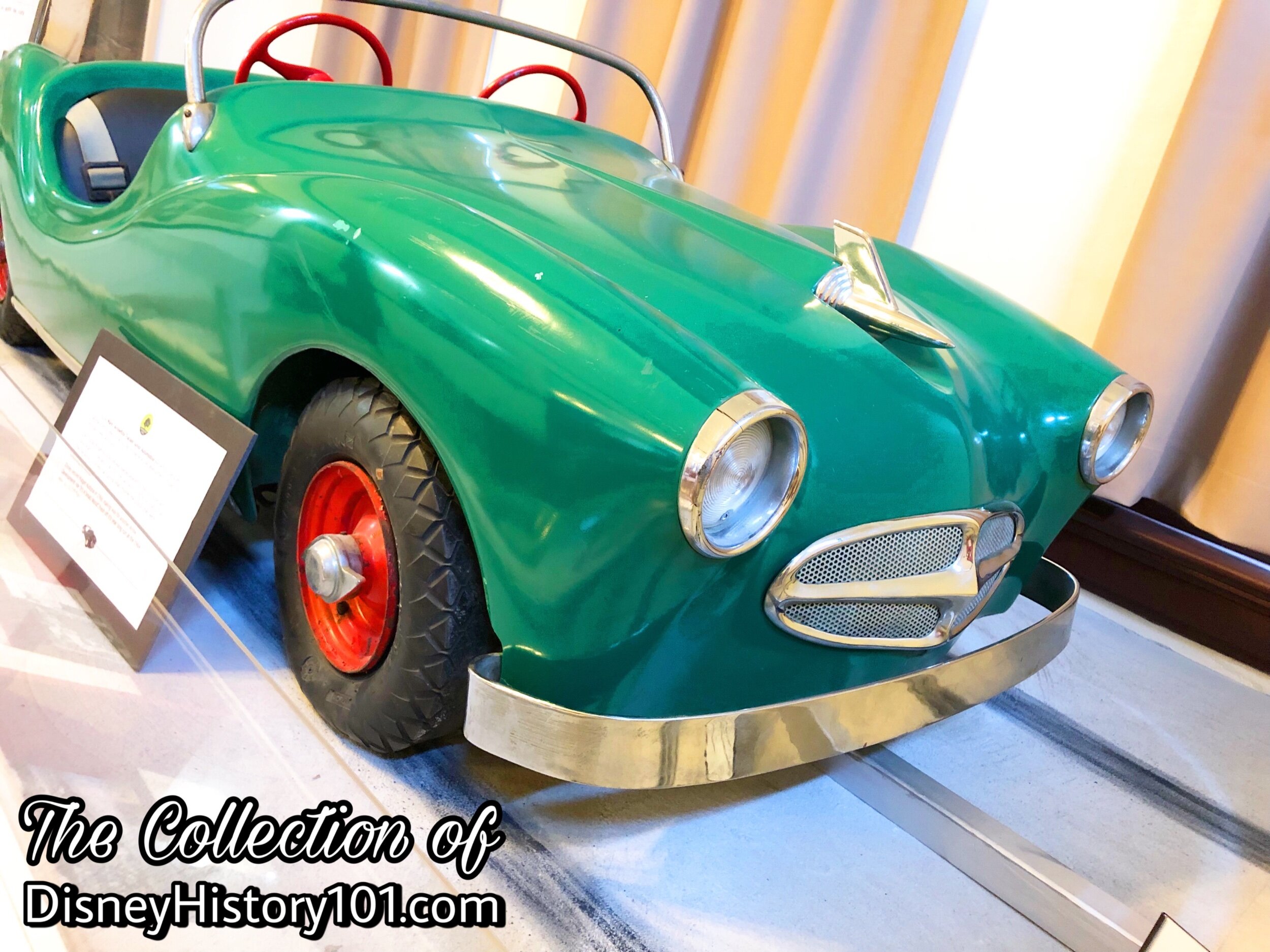
This museum restoration was very faithful to the original Midget Autopia vehicles that once ran through Marceline, Missouri and Disneyland. Circa 1957 Chevy hood ornaments were used for the Midget Autopia hood ornaments, while 1956 Pontiac “running lights” were used for the Midget Autopia vehicles’ headlight housings.
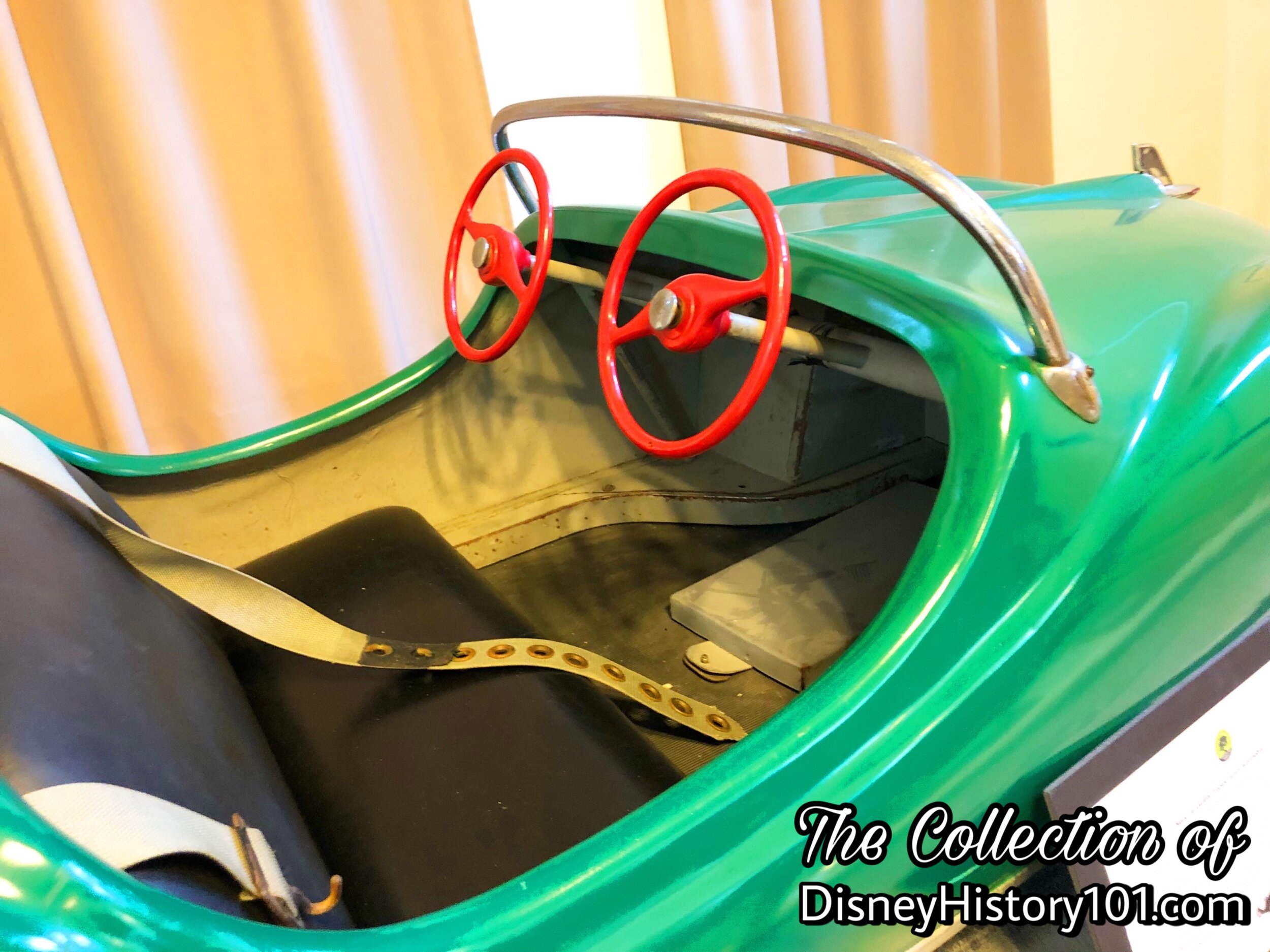
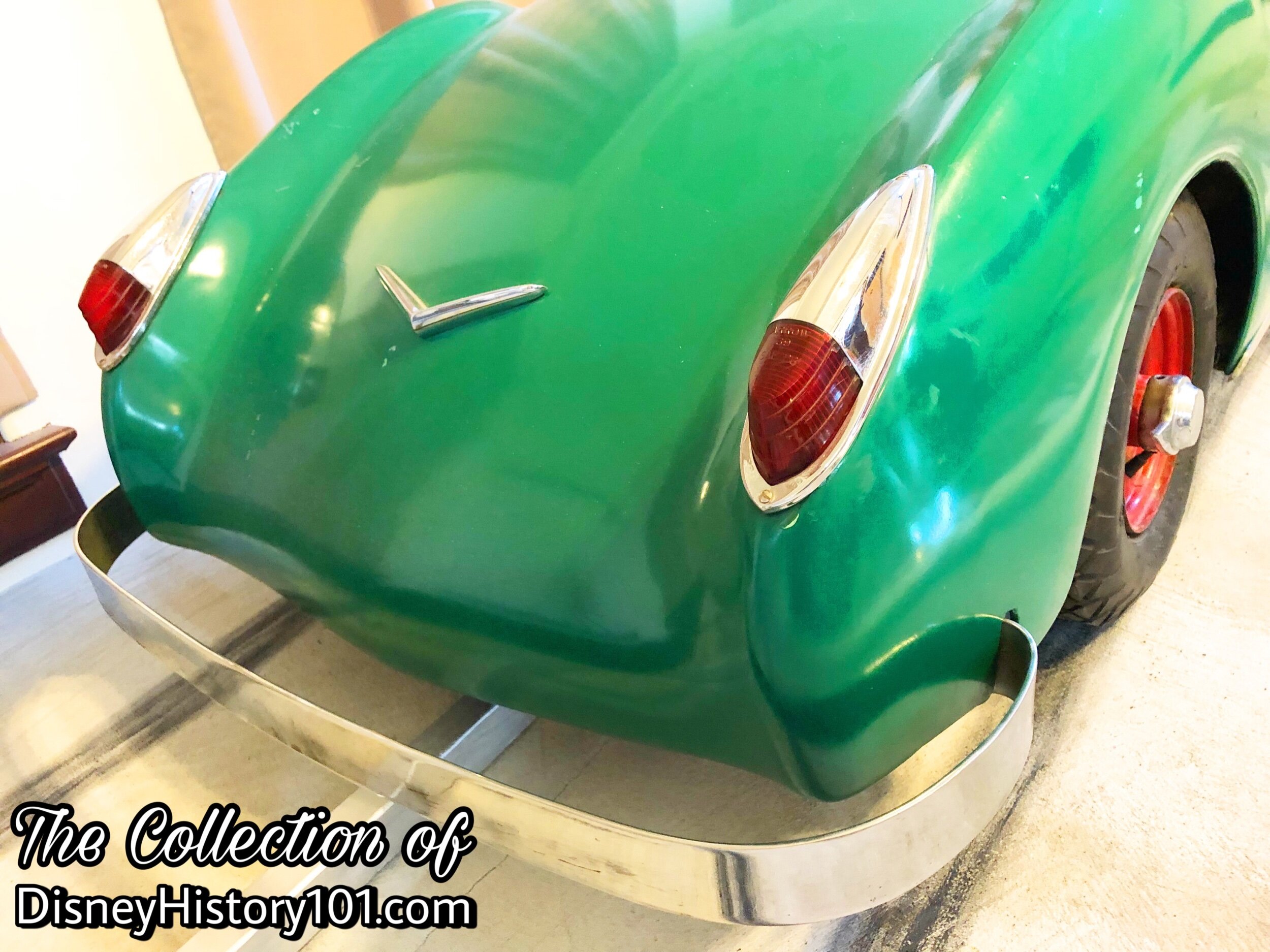
Whatever happened to the Midget Autopia, once it was removed? Lee Hoover (Walt Disney Hometown Museum) takes us “under the hood” of the Midget Autopia, as he shares the next exciting chapter of the beloved attraction, as well as current efforts to restore the only Disneyland attraction to ever be “relocated” outside the park by special permission of Walt Disney!
It’s all here in this “Disney History 101 presents People” featurette!

Whatever happened to the Midget Autopia, once it was removed? Lee Hoover (Walt Disney Hometown Museum ) takes us “under the hood” of the Midget Autopia, as he shares the next exciting chapter of the beloved attraction, as well as current efforts to restore the only Disneyland attraction to ever be “relocated” outside the park by special permission of Walt Disney!
It’s all here in this “Disney History 101 presents People” featurette!
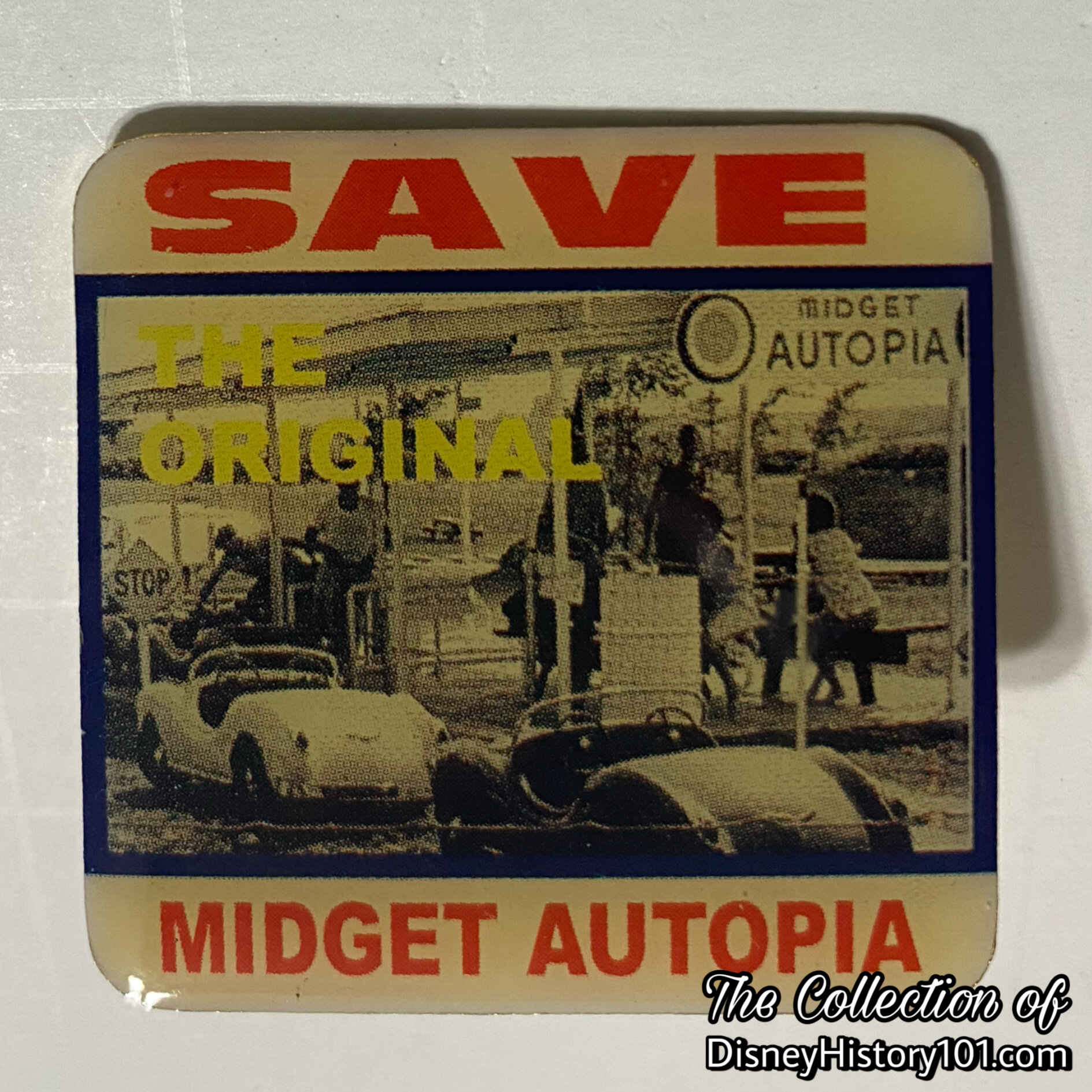
In honor of the 50th anniversary of Walt’s gift to the children of Marceline, The Walt Disney Hometown Museum planned a $500,000 Kickstarter campaign to rehabilitate and restore the Midget Autopia. The campaign began August 14th, 2015, coinciding with a Walt Disney Hometown Museum exhibit at D23 Expo in Anaheim, California.
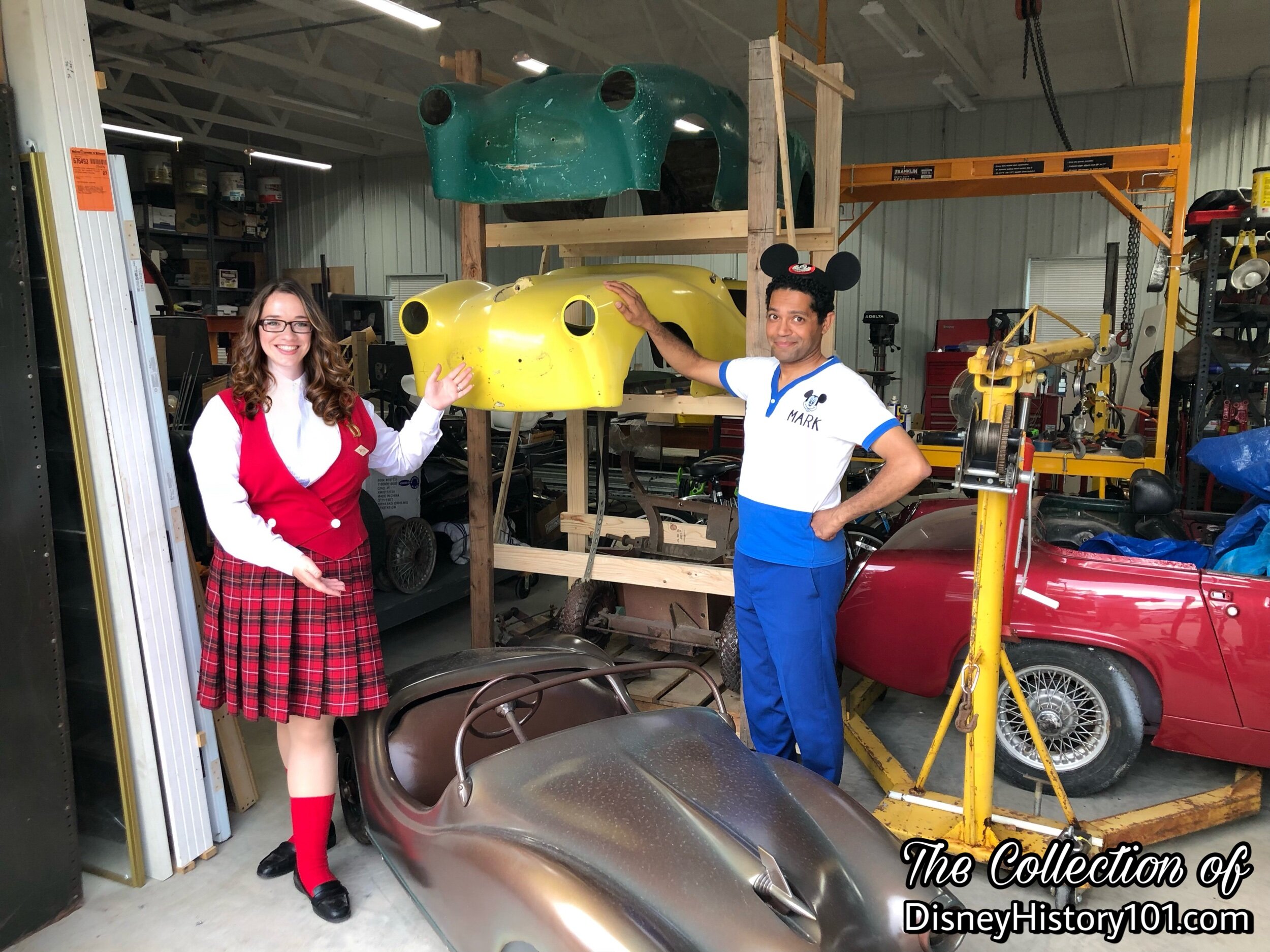
While visiting Marceline, Missouri (Walt Disney’s boyhood home, of which he later donated the Midget Autopia), we visited the location where some of the parts are stored, while awaiting an ongoing restoration and repair project.

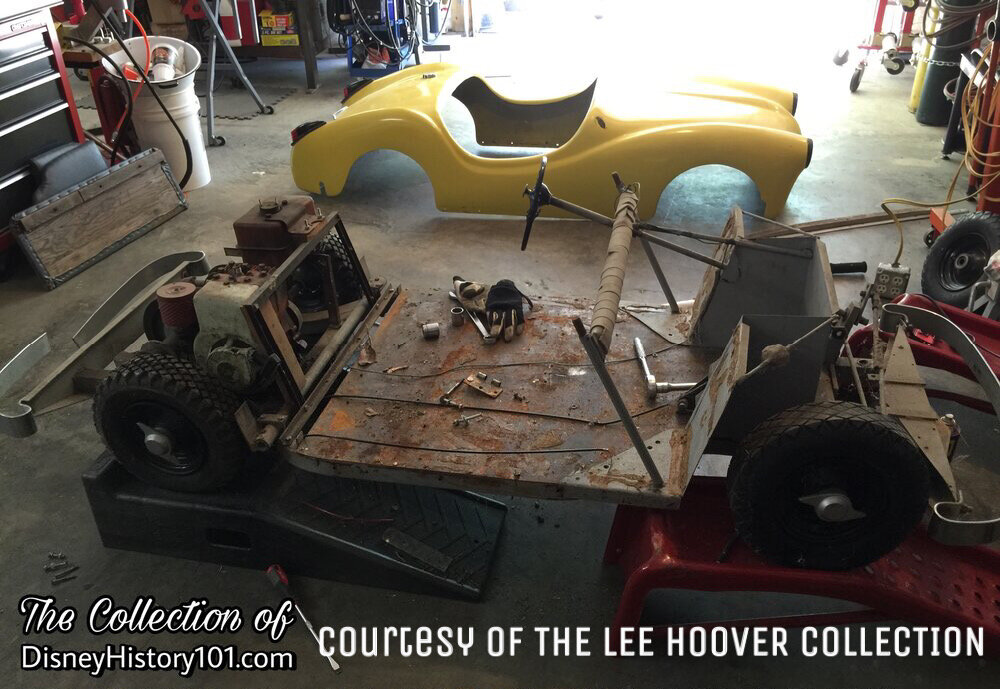
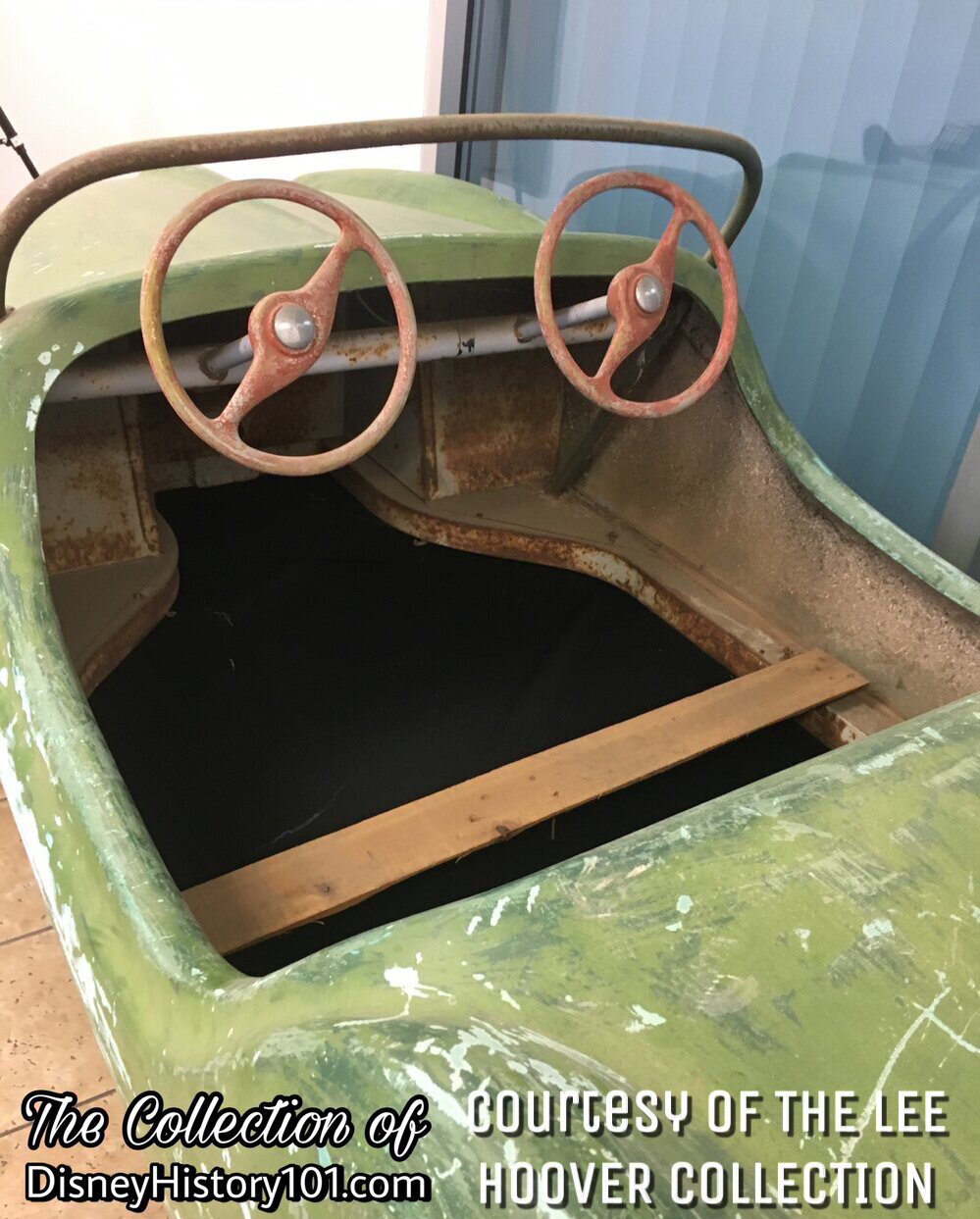

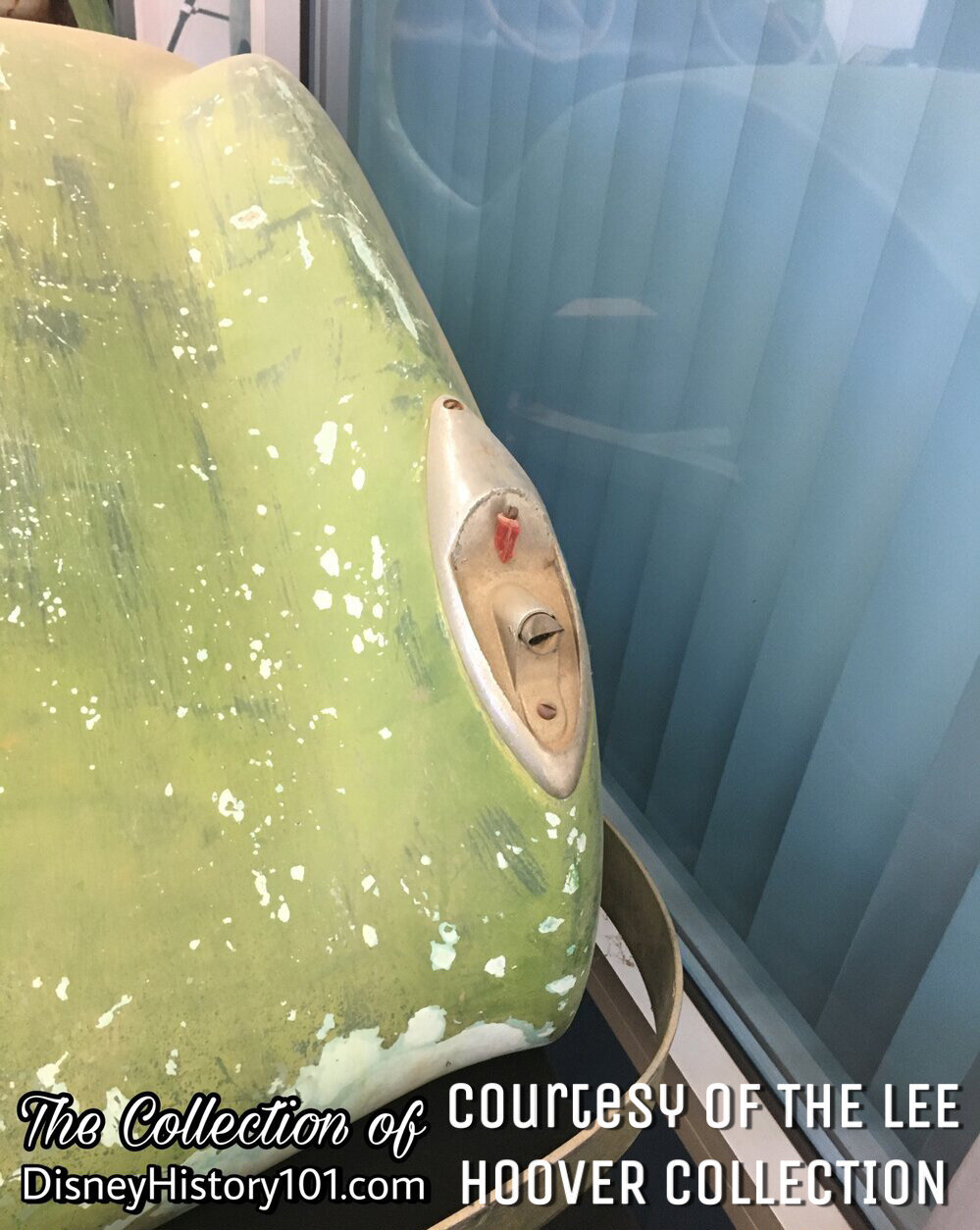
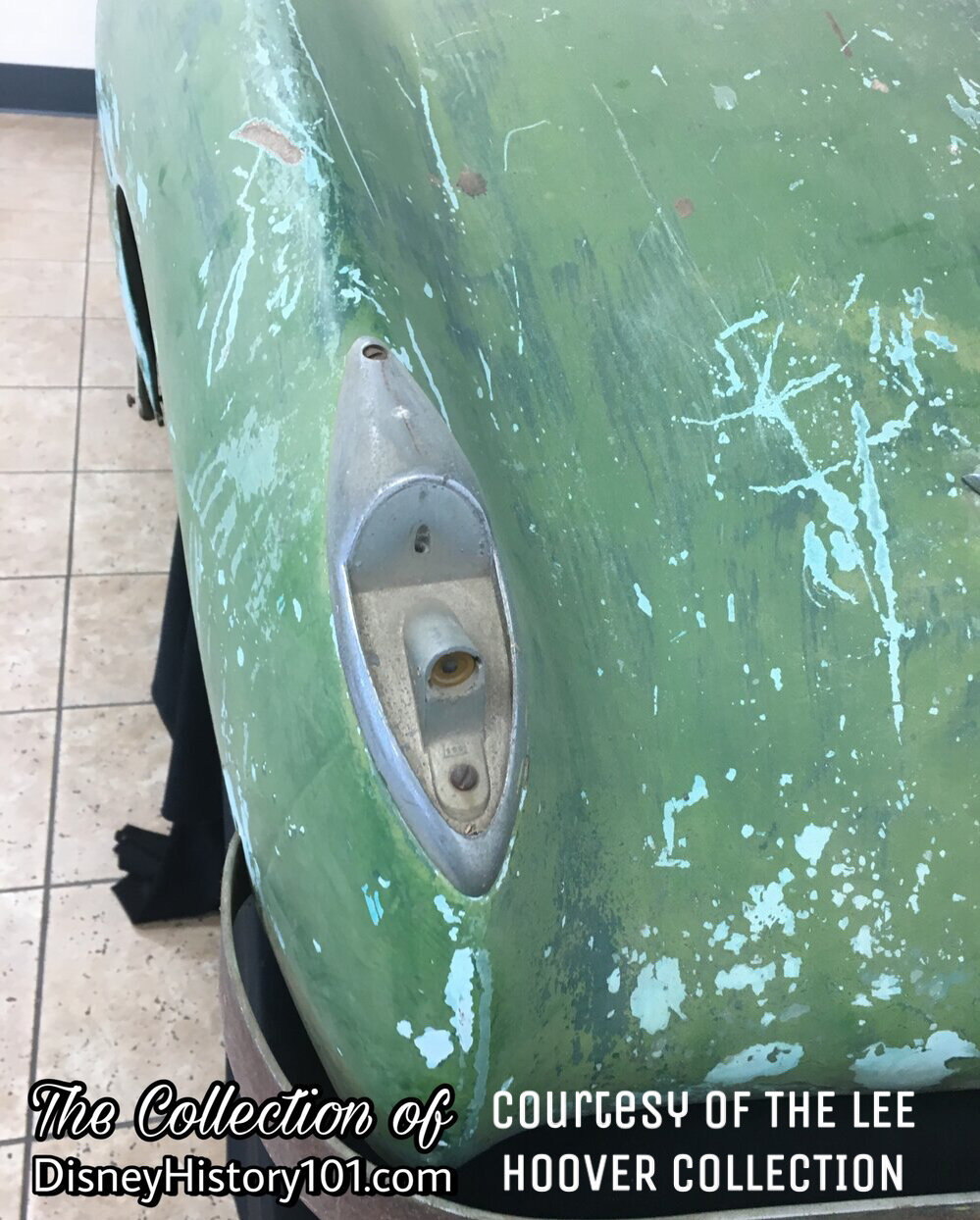
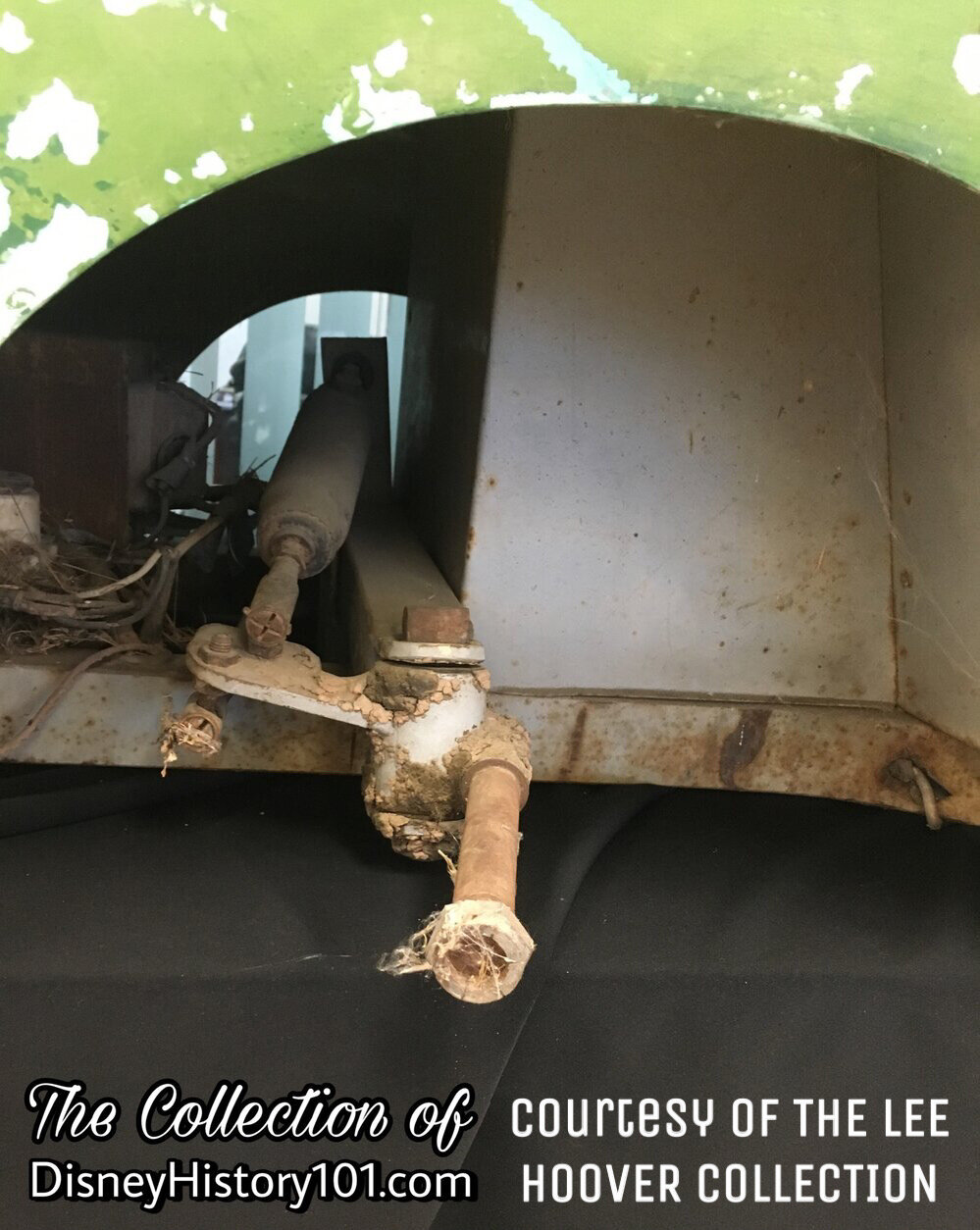
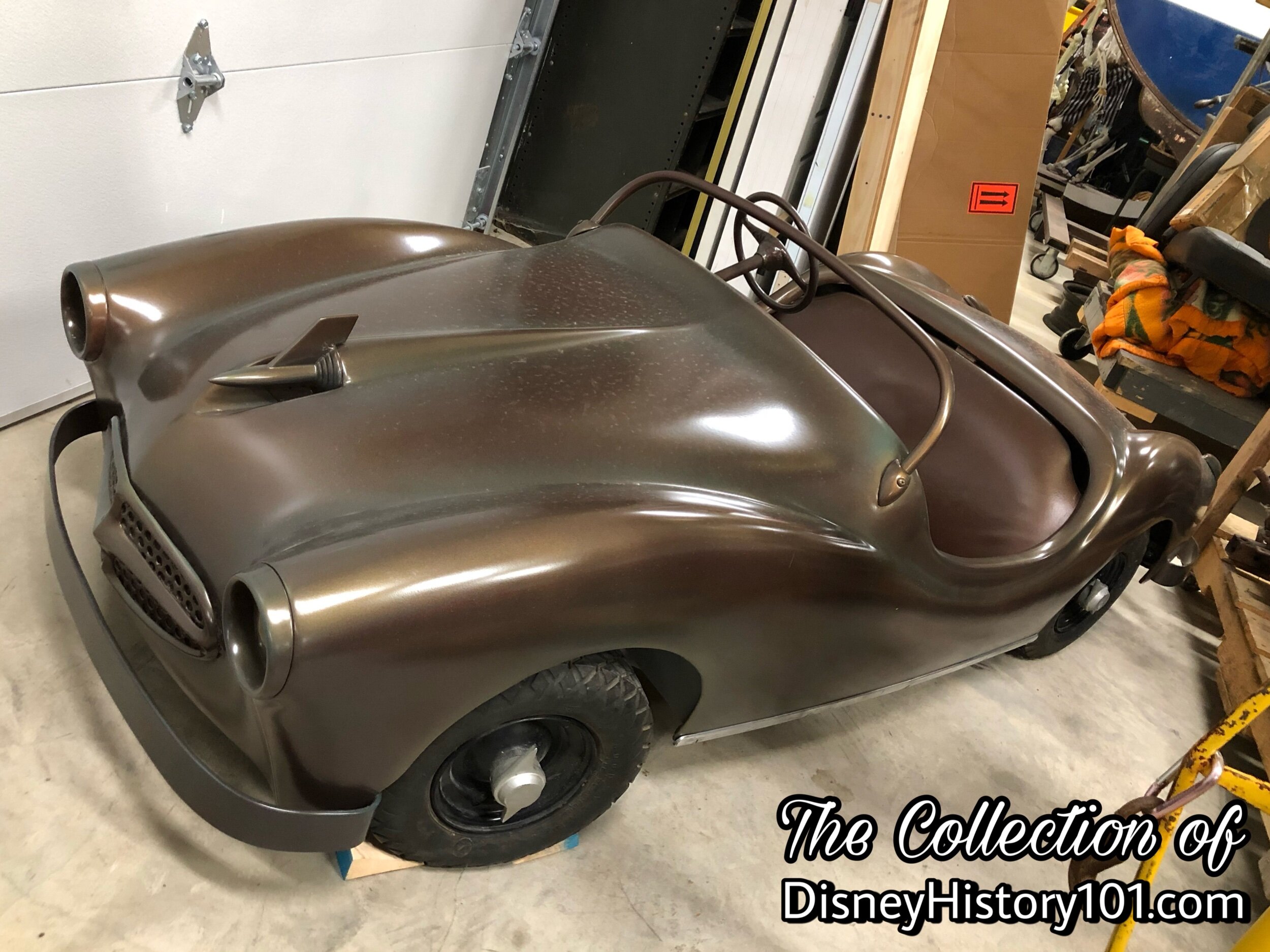
During the era of the Autopia Presented by Chevron, this bronzed Midget Autopia vehicle was preserved (to a degree) as a roadside prop on the Autopia stage (one of the non-operational steering wheels was removed). During the New Midget Autopia Track groundbreaking ceremony, this artifact was brought to Marceline, Missouri in an event, courtesy of The Walt Disney Archives, Disneyland, and D23.
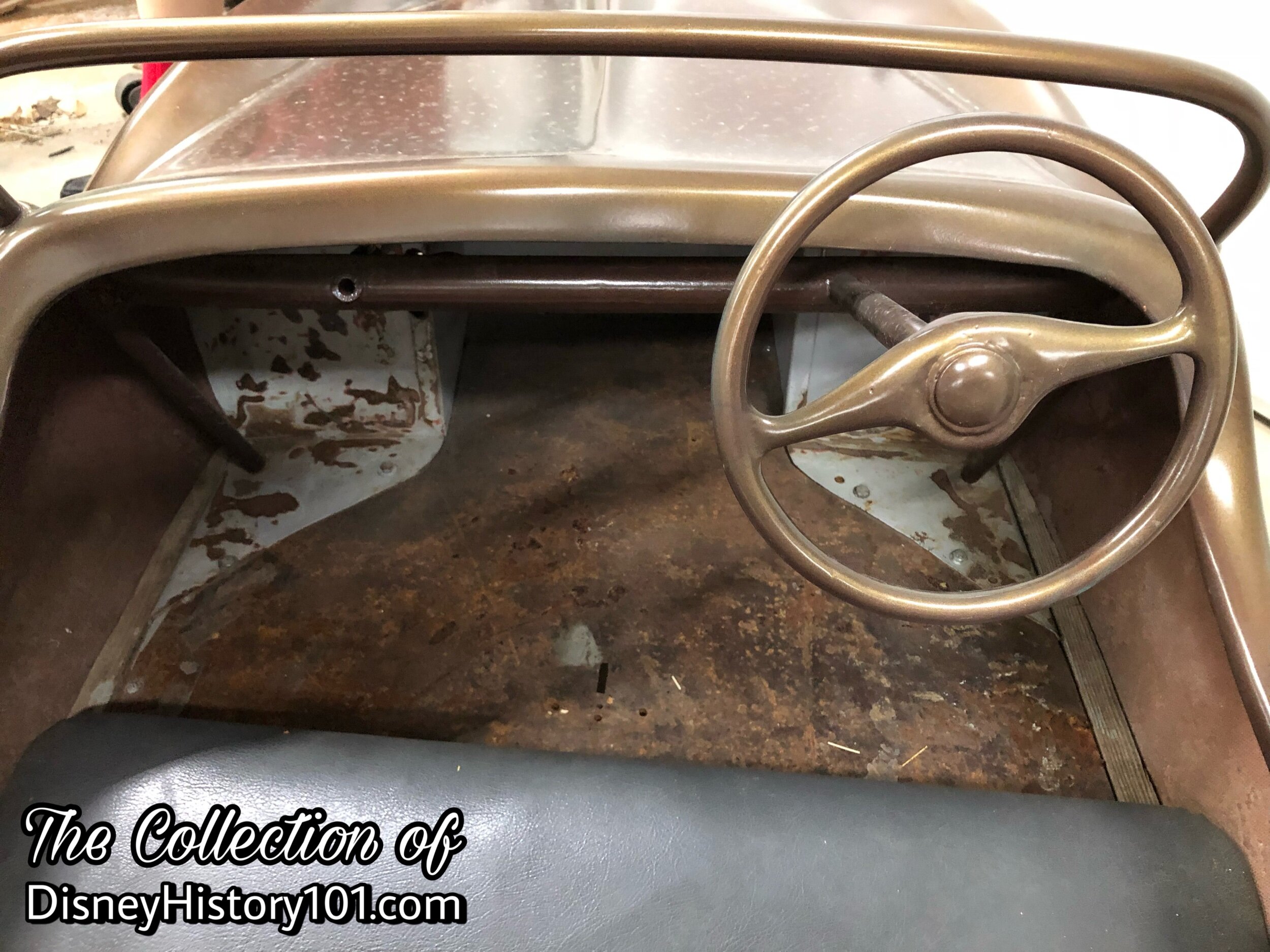
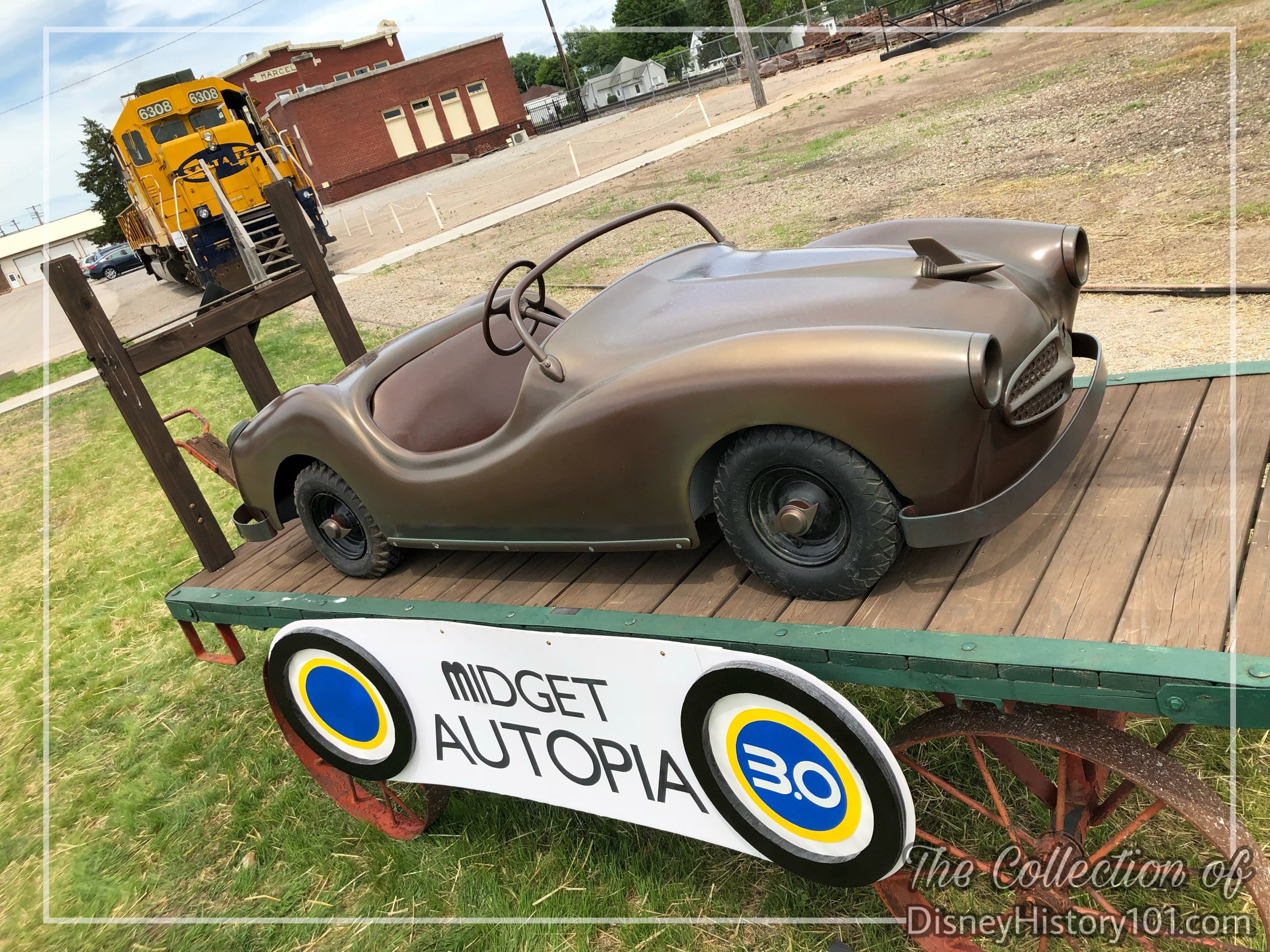
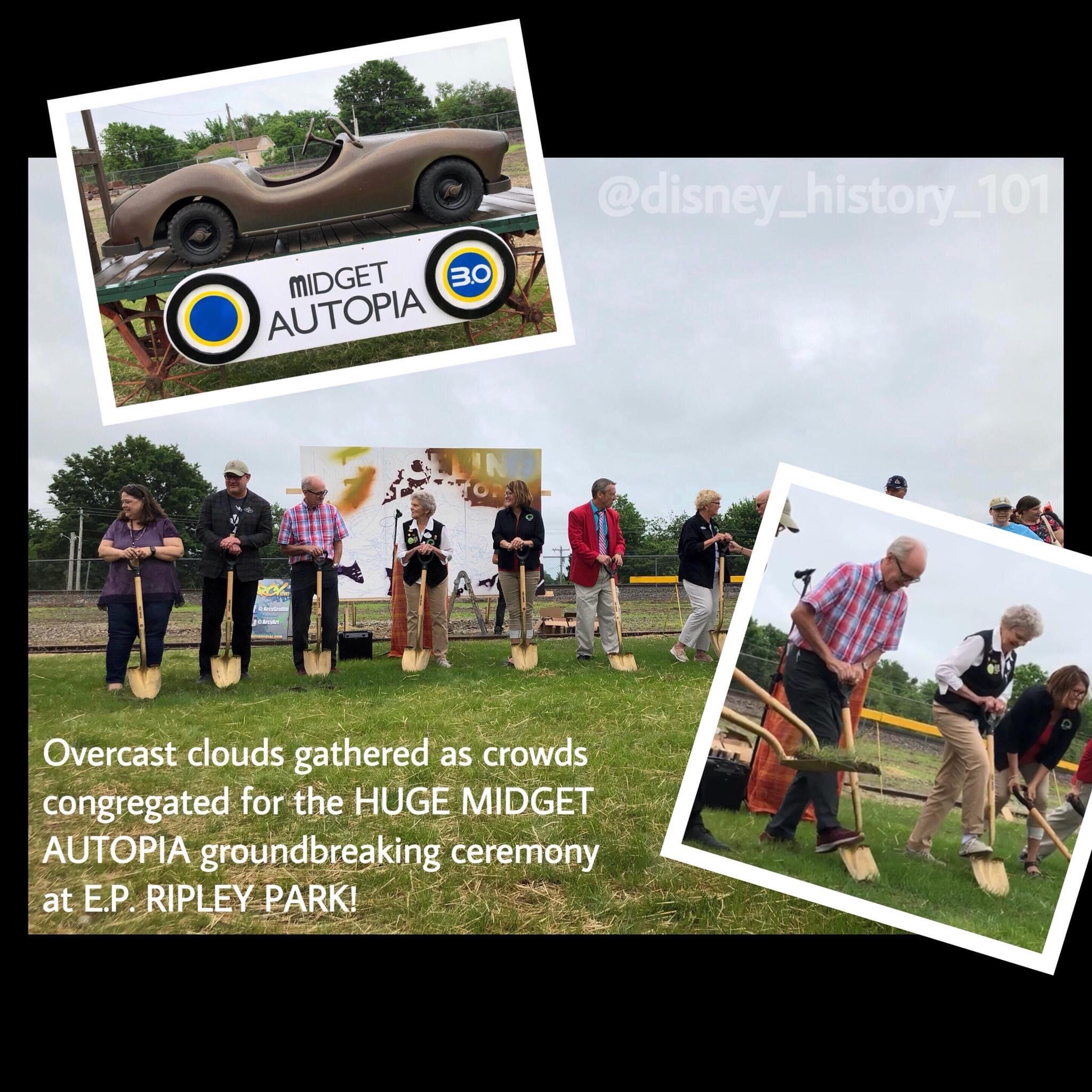
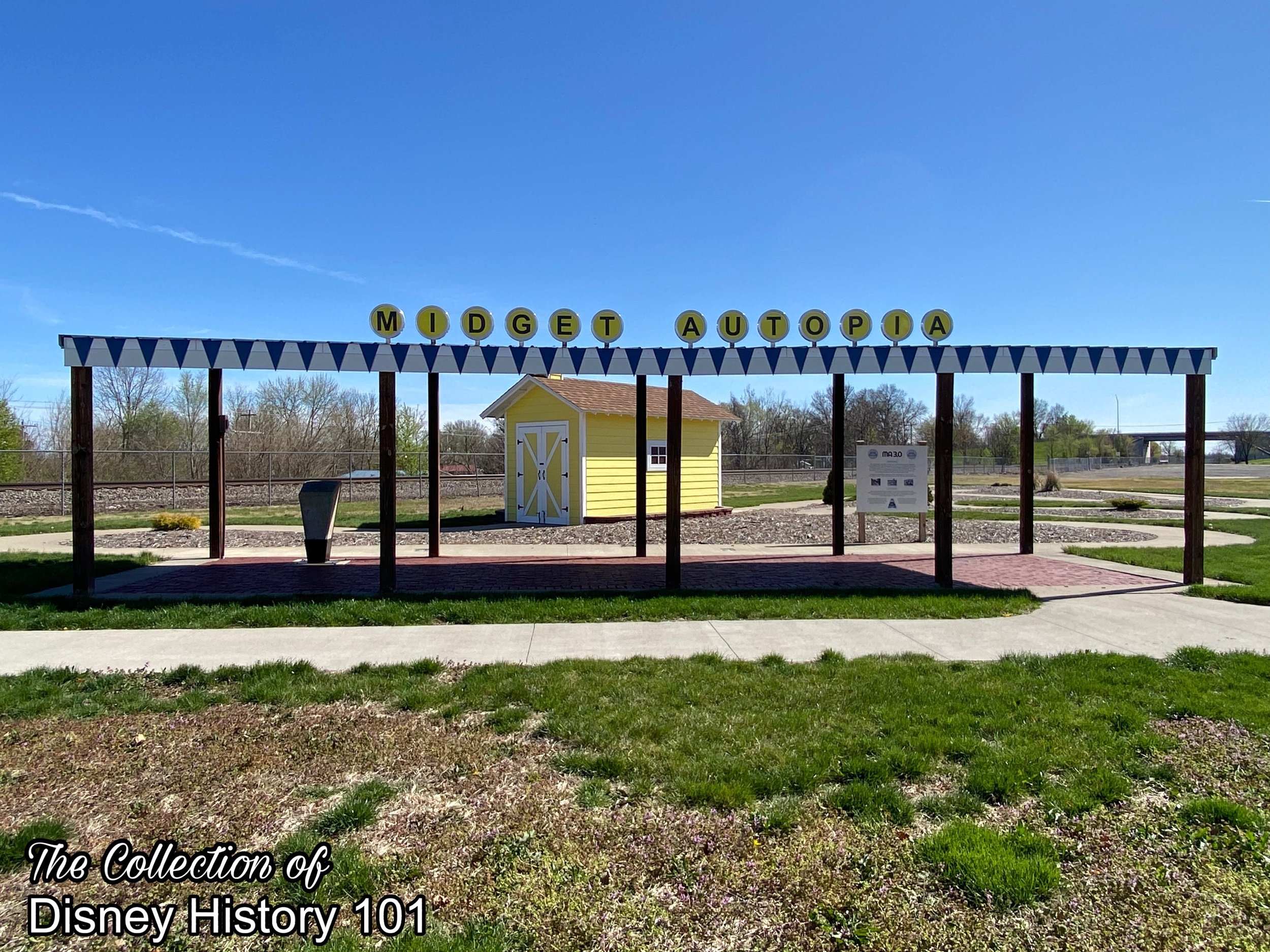
“This new walking track is a salute and heartfelt thank you to Walt and Roy. The layout you see before you was designed by Disney Imagineering, and is based off the original Disneyland footprint. This new trail gives curious visitors a unique opportunity to once again walk a piece of Disney history, and possibly relive a few fleeting moments of their own childhoods right here in Walt's boyhood hometown.”
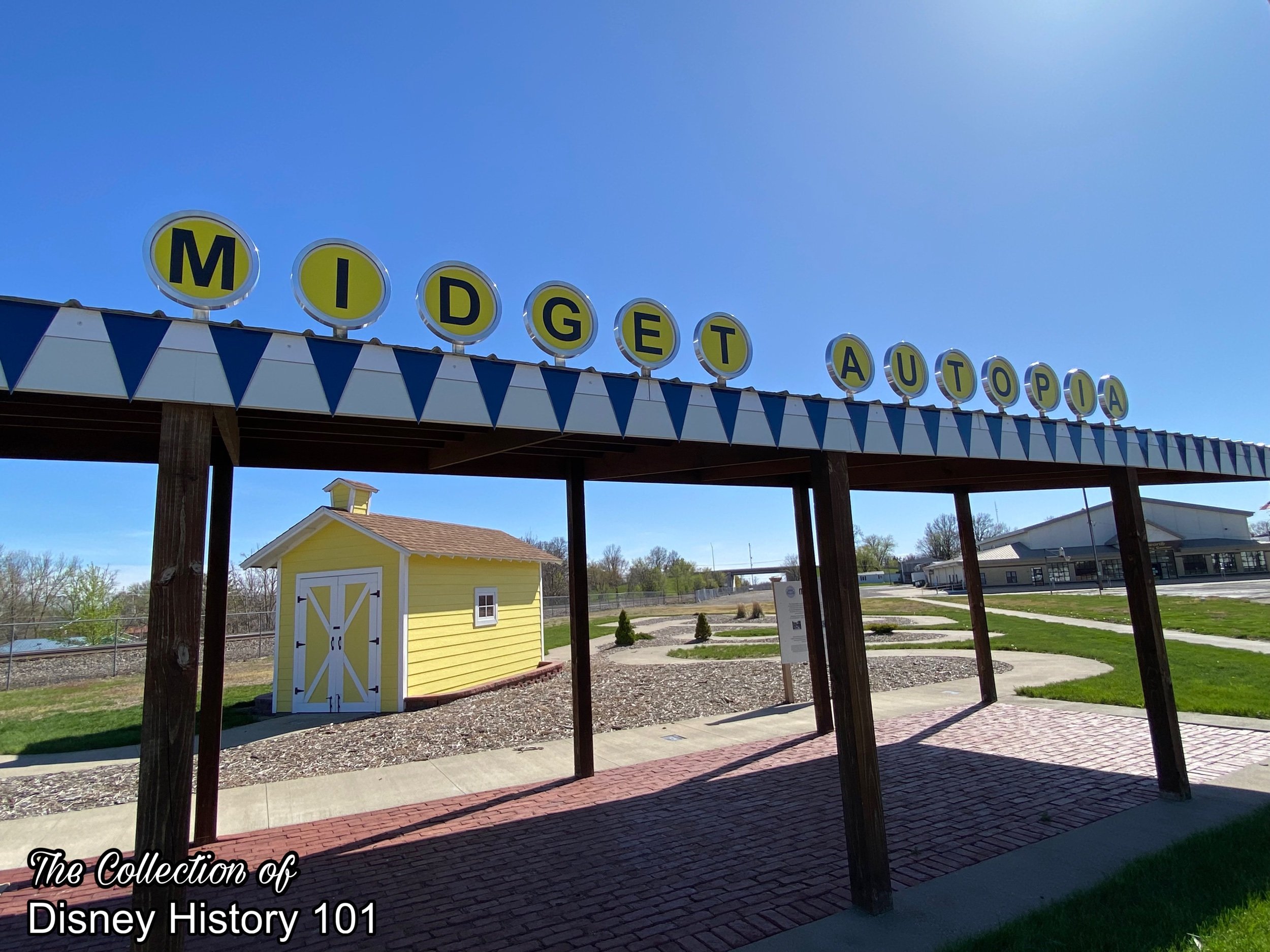
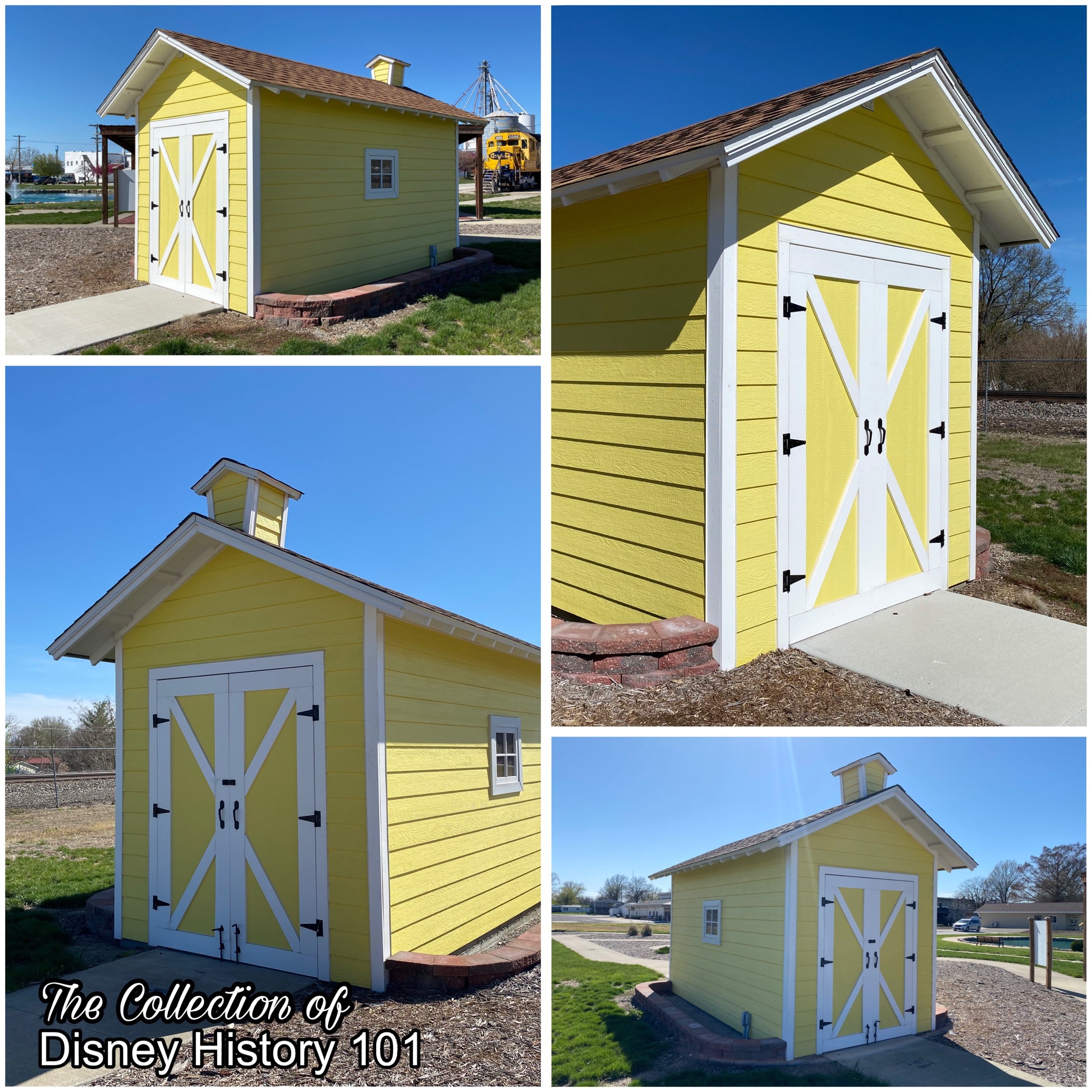
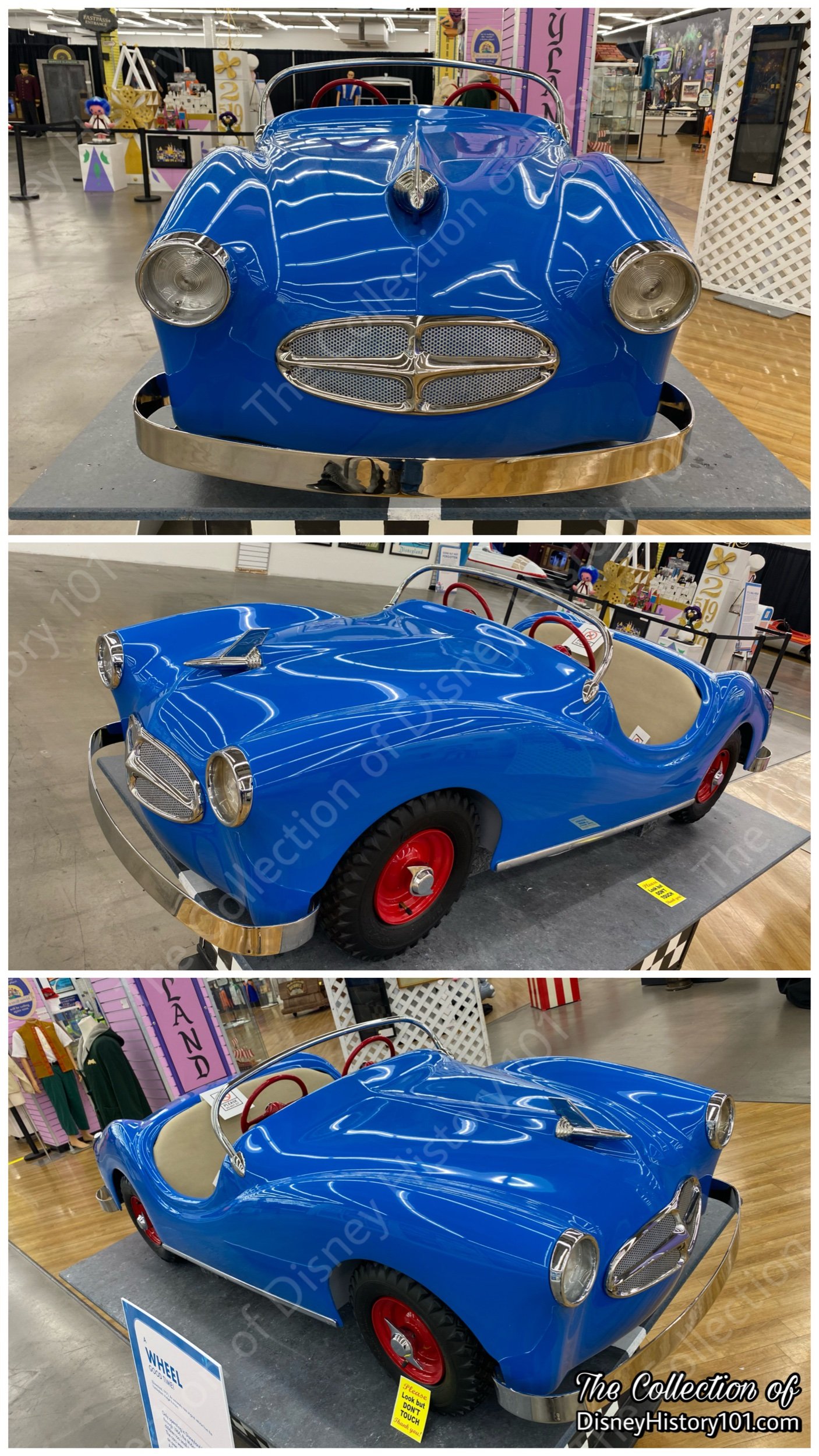
According to the catalogue, “This original car… features the original body, wheels, and steering wheel from Disneyland, with restored red rims with chrome spinners, a new wood and vinyl seat, windshield bar and "firewall" footrest, and decals. The taillights are S&M vintage 1950's replacements for the originals.”
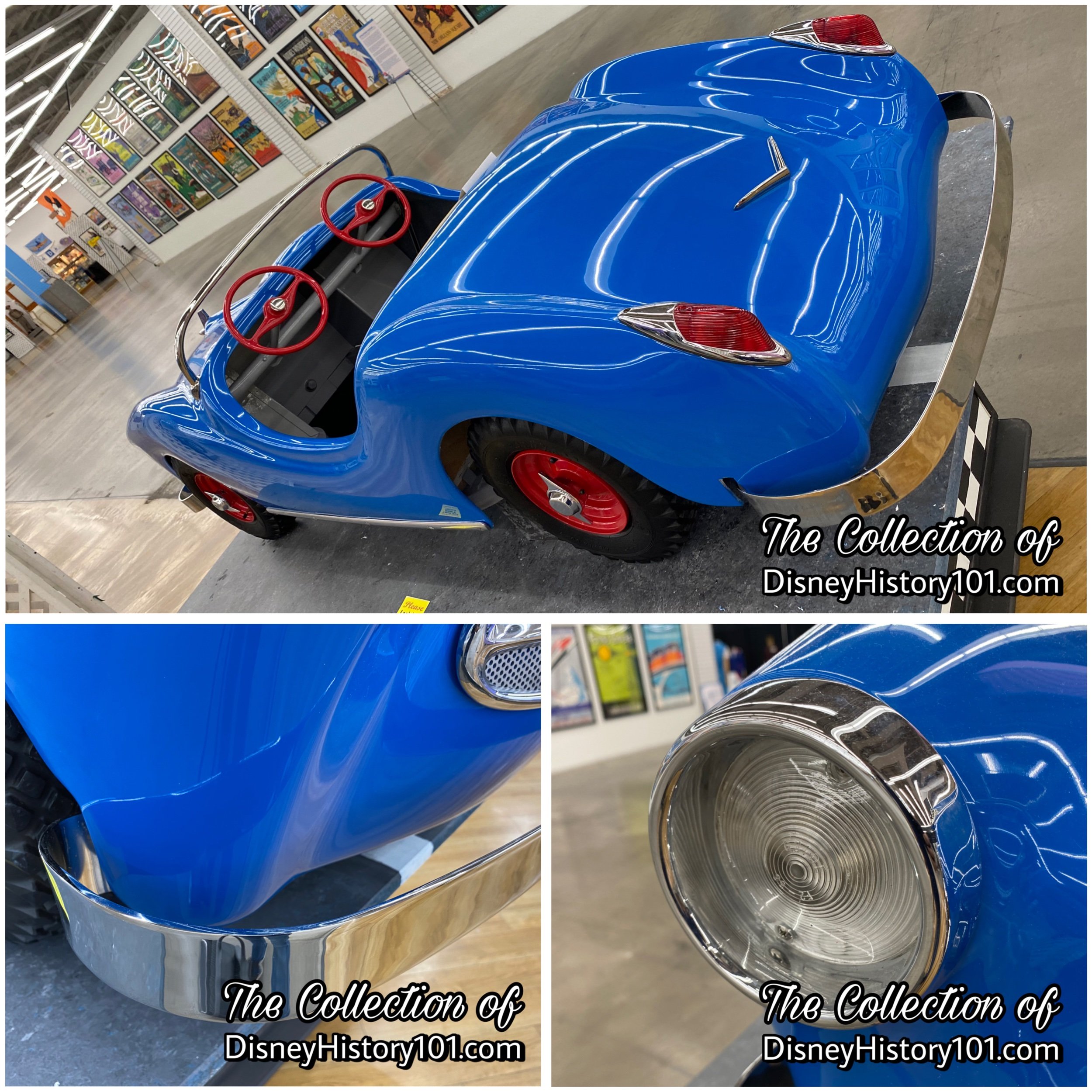
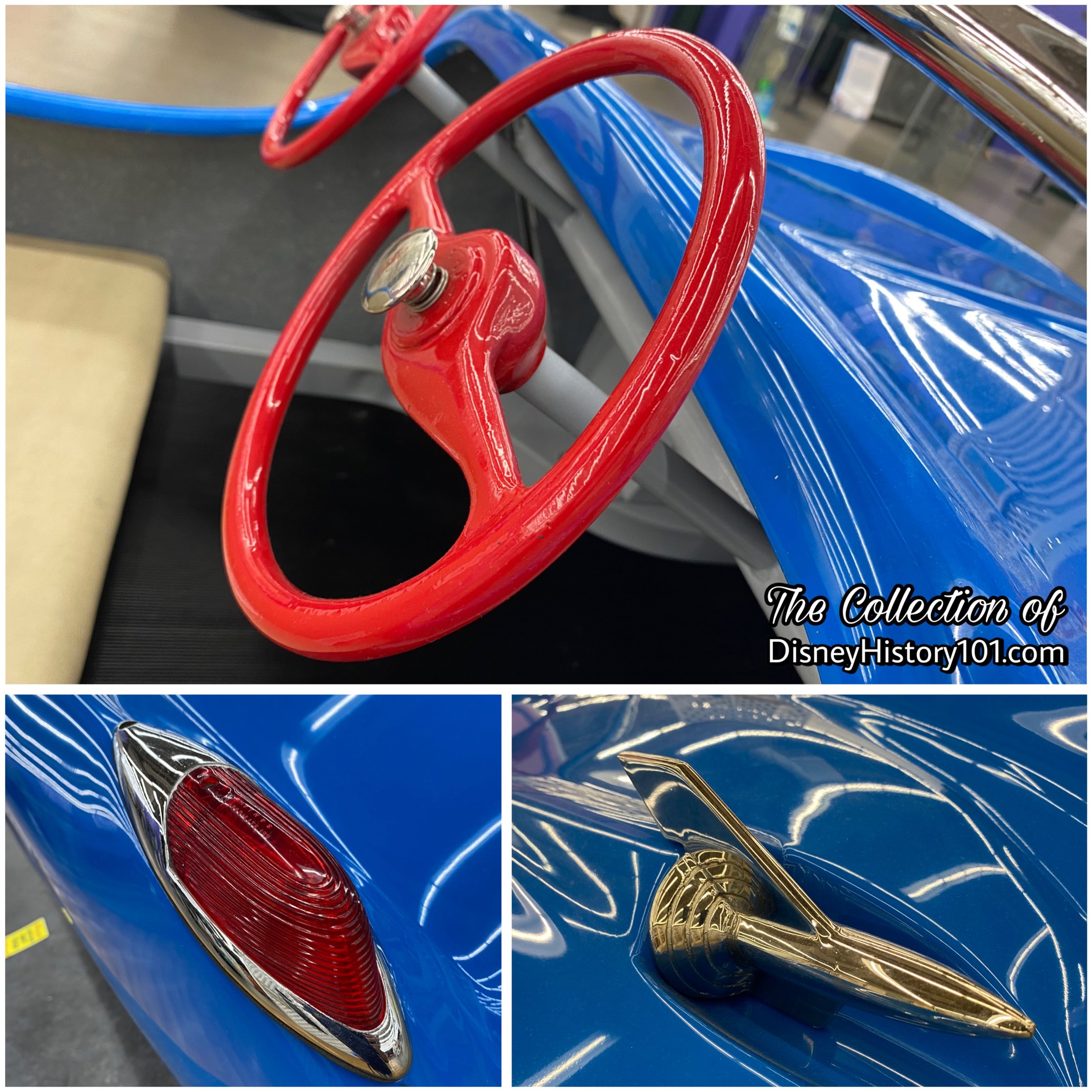
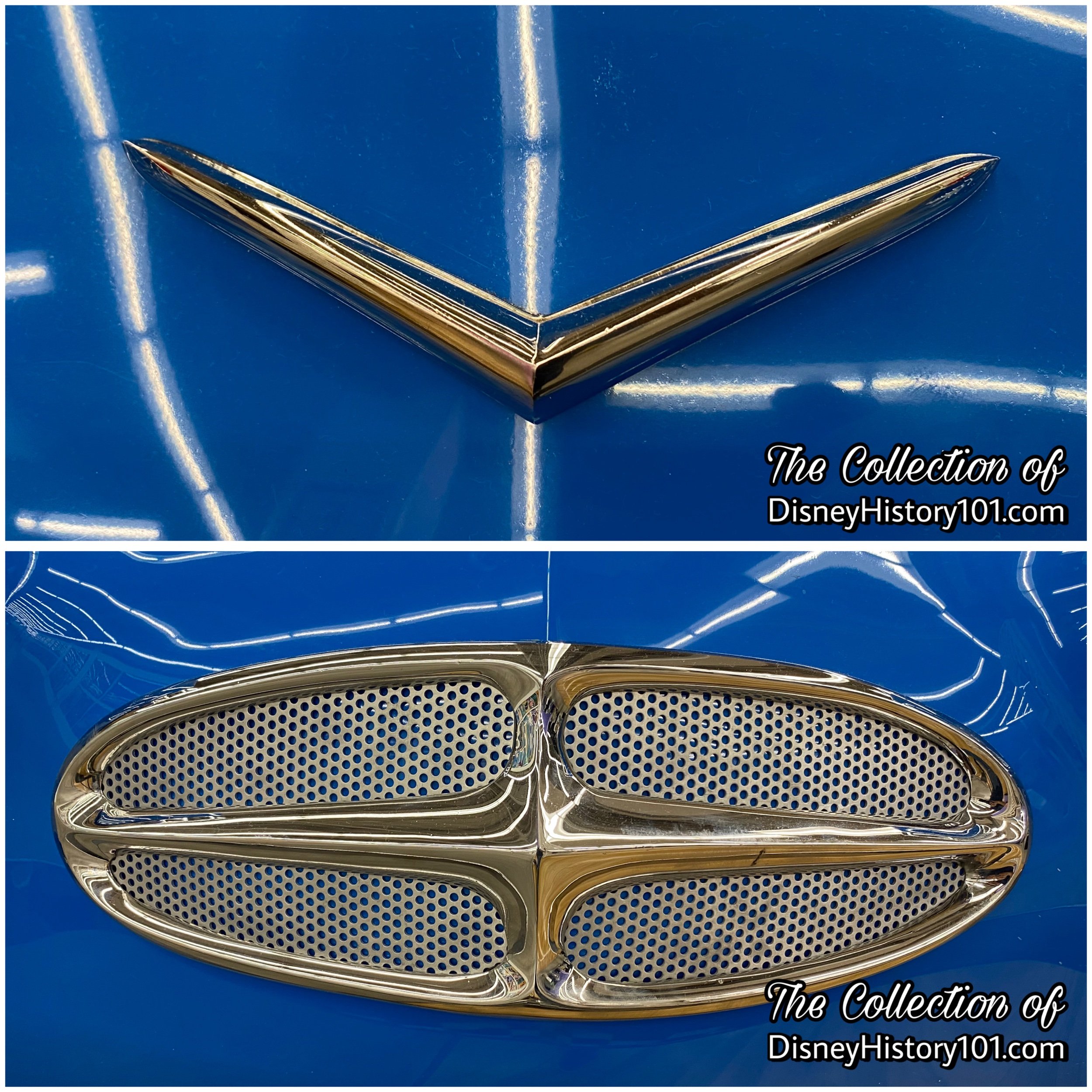
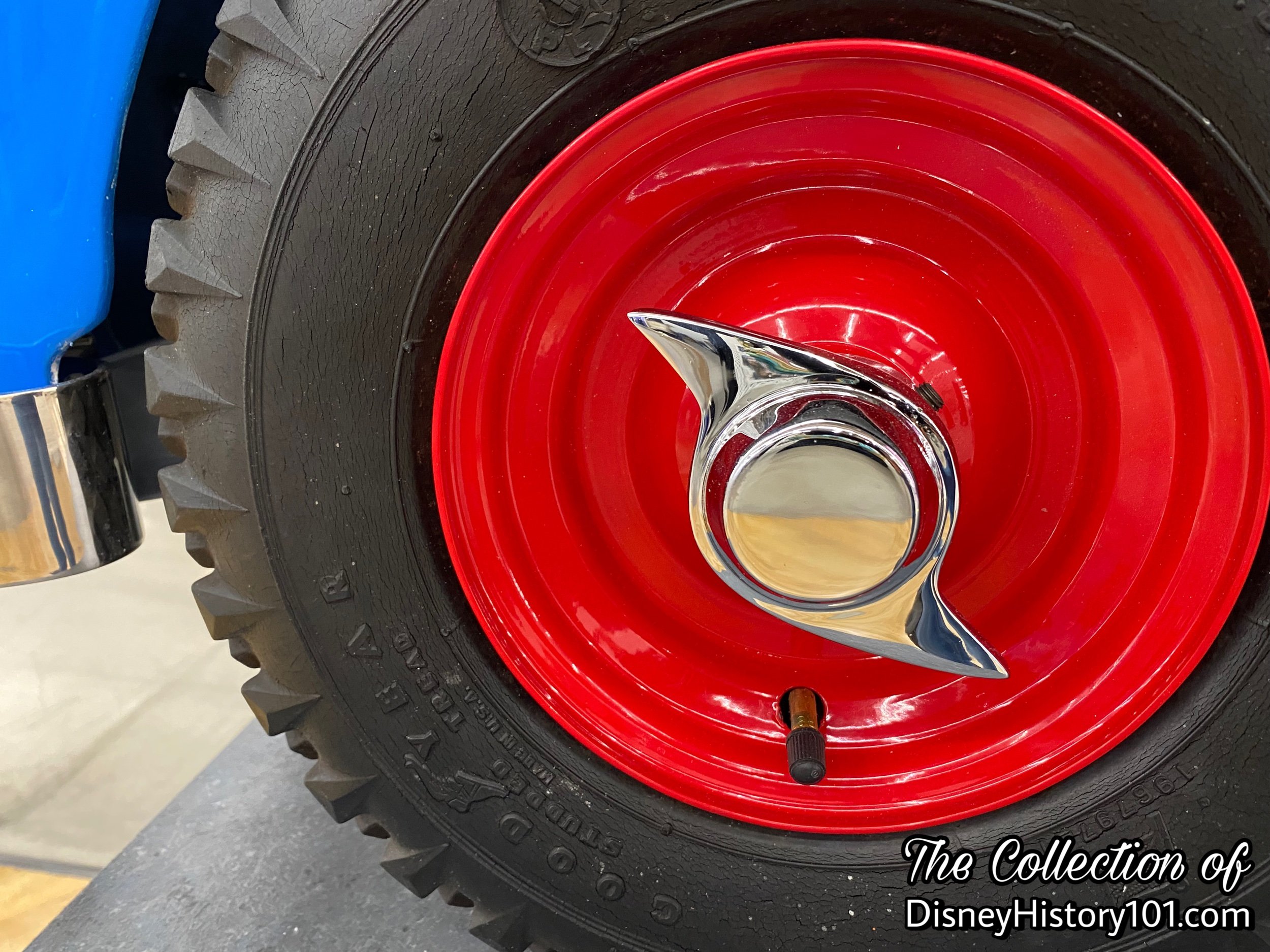
MINE TRAIN THRU NATURE'S WONDERLAND (RAINBOW CAVERNS MINE TRAIN)
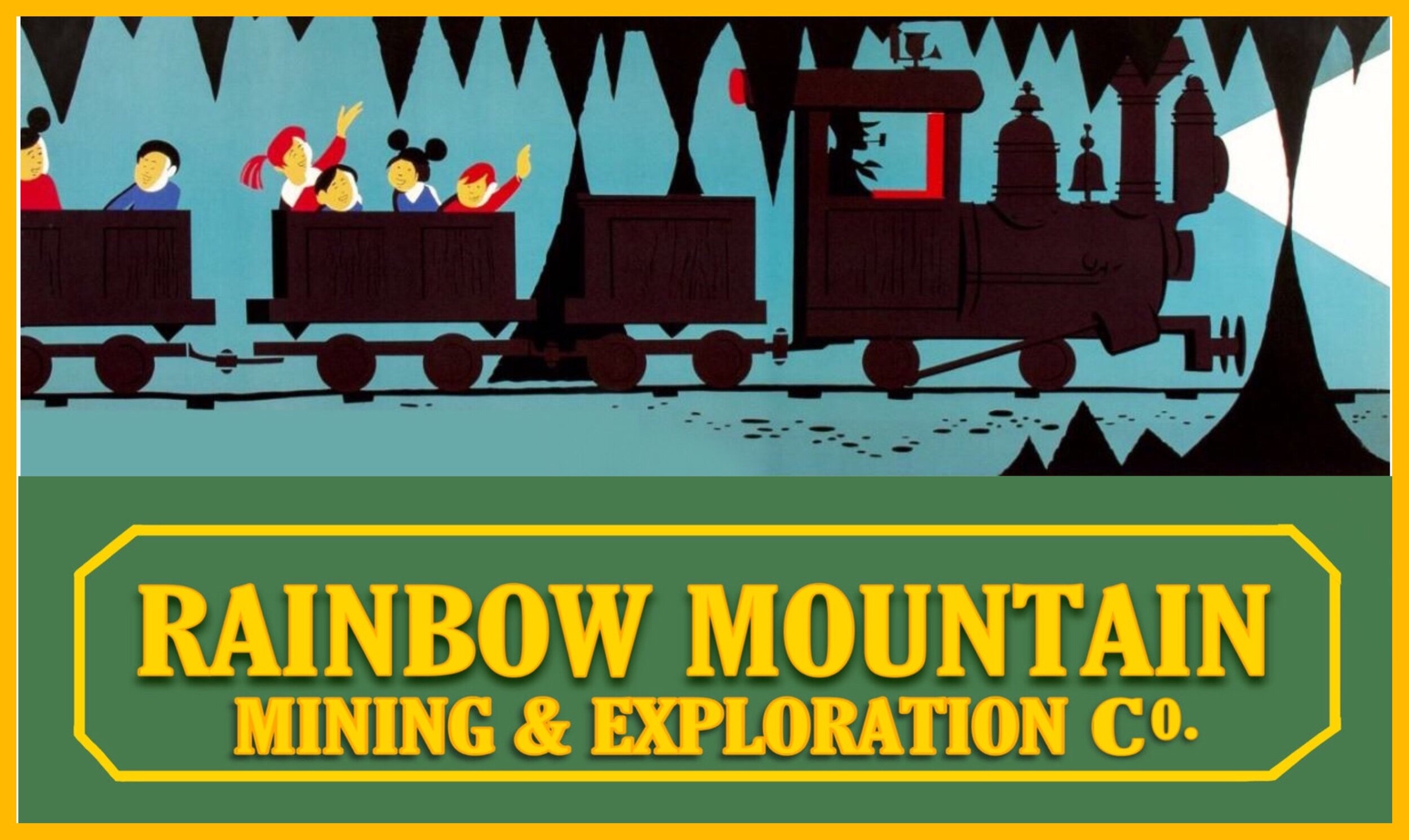
*Some sources (i.e. “Disneyland Rides & Attractions and Attendance Report” Fiscal Year 1981) cite July 1st, 1956
“HOWDY FOLKS! Welcome to the little mining town of Rainbow Ridge - the gateway to Nature’s Wonderland.” When Disneyland first opened there were only a few ways to explore this portion of Frontierland - all of them by horse or mule. There were Stagecoaches, Conestoga Wagons, Yellowstone Coaches, and mule trains which traversed seven acres of Disneyland to bring it all to life.
“New Pages of the Disneyland Story”
Now, on the eve of Disneyland’s first day of operation, Walt had promised that “Disneyland will never be completed. It will continue to grow, to add new things, as long as there is imagination left in the world.” So it must have seemed strange to some when a year later (during 1956), “a few of Disneyland’s fabulous rides closed temporarily, [when] construction operations in Frontierland… made it necessary to shut down the three ‘Painted Desert’ rides - the Stage Coach, the Mule Pack Train and the Conestoga wagon,” according to “The Disneyland News” (Extra Edition). Only a few days prior, at a meeting of the Disneyland Merchant's Association (held January 25, 1956), a momentous announcement was made: “All horsedrawn vehicles in the Frontierland area will be shutdown for approximately two months, during the redesign and reconstruction of this area. This will be a whole new development to increase ride capacity. We are building a mountain to be called Rainbow Mountain. This will be seen from the River and the Mark Twain. The existing corral and Black smith Show will be the entrance to a new ‘Mine Train’ ride. This will be an old fashioned Mining Train with 6 open cars. The engine will look like a real engine. The ride will go through a canyon out into the desert; then into a Rainbow Mountain where you tunnell with stalagmites and stalactities and three different water falls of different colors, joining in the river. This ride will take about 6 minutes. One of the most interesting rides we have in the park is the True Life Boat Ride. Me hope to make the ‘Mine Ride’ an equal to that one.”
Though Walt set the “Painted Desert” budget at $400,000, nearly $500,000 of improvements (of a total $1.5 million total Park investments for 1956) brought major developments and “reconditioning” to the Painted Desert area of Frontierland! A new town sprang up in the hills overlooking Frontierland, newly rails were laid, and the opportunity arose to head past rushing rivers and into the uncharted caverns and caves of the Painted Desert! “Towering above the scene, Rainbow Mountain provides a snow-capped background for all this action,” according to the “Disneyland 1st Anniversary Souvenir Pictorial,” published 1956.
As some of these new Frontierland attractions appeared on page 5 of The Disneyland News (published June of 1956), the Rainbow Caverns Mine Train began to prove the truth of Walt Disney’s promise of an ever-expanding Disneyland! Similar to how Walt Disney’s True Life Adventure series spawned True Life Adventureland, Nature’s Wonderland (and its refurbishment) were directly influenced by films released from 1950 to 1954. But while those films were “two-dimensional in scope, the Theme Park surrounds the guests with the story and impacts all of their senses”, according to “Disney By Design” Tour scripts. Artists like set designer Wilson “Bill” Martin (who had left 20th Century Fox, to work on Walt Disney Productions’ Disneyland project) was influential in the design of Nature’s Wonderland, his talents as art director applied to the attraction.
Though total investment for Disneyland had now reached $18,500,000, the rich story of the Mine Train was among the attractions that were projected to add a 40% ride capacity to the Park!
Today, our story begins at a junction in the small mining town of Rainbow Ridge. Instead of saddling up atop a dusty pack mule, we’ll load into a mine train gondola for what would typically be a seven minute excursion, en route to a “wondrous” destination tucked deep in the earth! A place where (according to Holiday magazine, published Summer, 1958), “seven multicolored waterfalls cascade and stalactites and stalagmites form beautiful patterns.” However, today we won’t look at our watches, or worry about the uniform “trip time.” We won’t heavily rely on the pre-recorded voice-over narration of Dallas McKinnon, or the script. Instead, I’ll be providing a custom spiel along our journey, which will be of an undetermined time length.
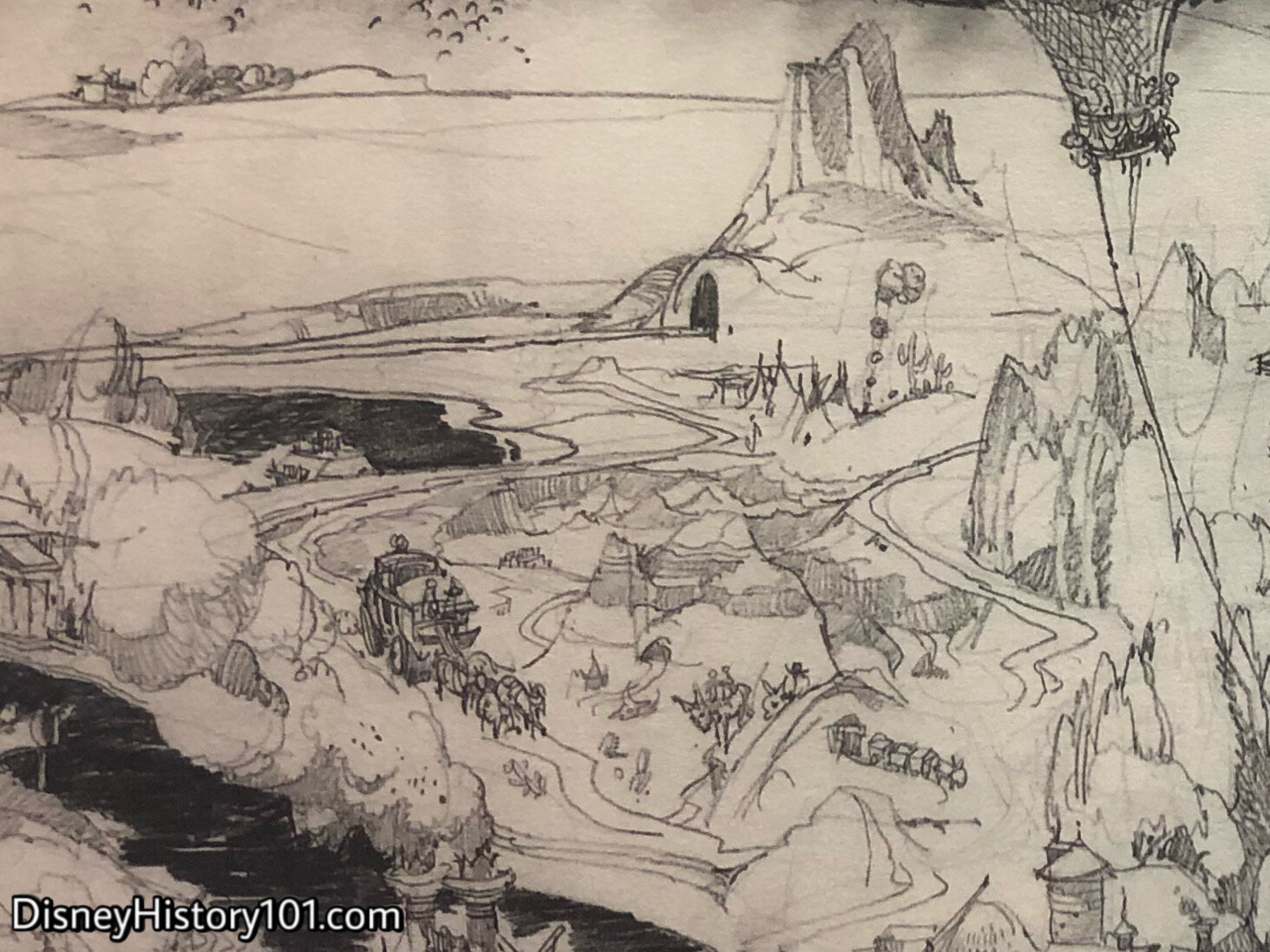
Herb Ryman hand-inked, and hand-colored one of the original Disneyland concept drawings between September 26th and 27th, 1953. Subsequently, hundreds of drawings were made, based on the original (with constant modifications being made, as Walt Disney’s “Disneyland” developed). Some of these viable project Concepts (as above), were supported by a well-developed business case and built expectation.
“The Painted Desert” (the name used to identify this region during 1955), appeared on the early drawings of Disneyland that were shown to potential investors as early as 1953. However, it seems (as depicted in the drawings) that it was only meant to be traversed and explored by way of a Stagecoach or Mule Train. The “The Disneyland Story” describes the scenery of the “Painted Desert” : “As you go into the Painted Desert you will pass the Indian encampment, go through a Pine Forest, and Ford a stream. When you get to the Painted Desert you will see the things you usually find there, such as the beautiful cactus plants, trees, probably the water hole with the ‘poison sign’, the skeleton of a steer, and other appropriate dressings of the desert. As well as the stage coach ride, you will be able to take the Conestoga Wagon and Mule Pack ride into the Painted Desert.” For a time, it does not appear that a Mine Train was considered an option to explore the Painted Desert.

Above is a Walt Disney Artist's conception of a section of FRONTIER-LAND in Disneyland, featuring the awe inspiring Mine Train Ride, the exciting Stagecoach and Mule Pack Rides, where one can journey through the many fantastic sights of the Rainbow Desert and Rainbow Mountain areas, returning with a view of the famous Mark Twain River Boat and Tom Sawyer Island. Just outside the mining town of Rainbow Ridge sat the boarding station for the pack mule train. Now, there were “three wonderful ways” to enjoy the Painted Desert at Disneyland.
This illustration (created for Guide Books and merchandising) gave us a clear view of the ‘natural wonders’ that await Mule Trains, Stagecoahes, and little dark-green Mine Trains in the “Rainbow Desert” (the name used for this region from 1956 to 1959)! If you look real careful, you can see the destination reserved for the passengers of mine trains. A small cutaway on the side of Rainbow Mountain, reveals a preview of the magnificent Rainbow Caverns!
Elevation drawings were still being prepared as late as May of 1956, to assist in land grading, and the integration of the paths of the “Stage Road,” the “Mule Overpasses” and “Mule Crossings,” and railroad tracks. Soon, the “bandsawn” shadowy forms of Rainbow Caverns, and pipe water sources were installed to flow over “metal cones” for form. Then, the headline of “The Disneyland News” (Vol. 2, No.2 ; August, 1956) heralded the “Mine Train Ride Now Open!”
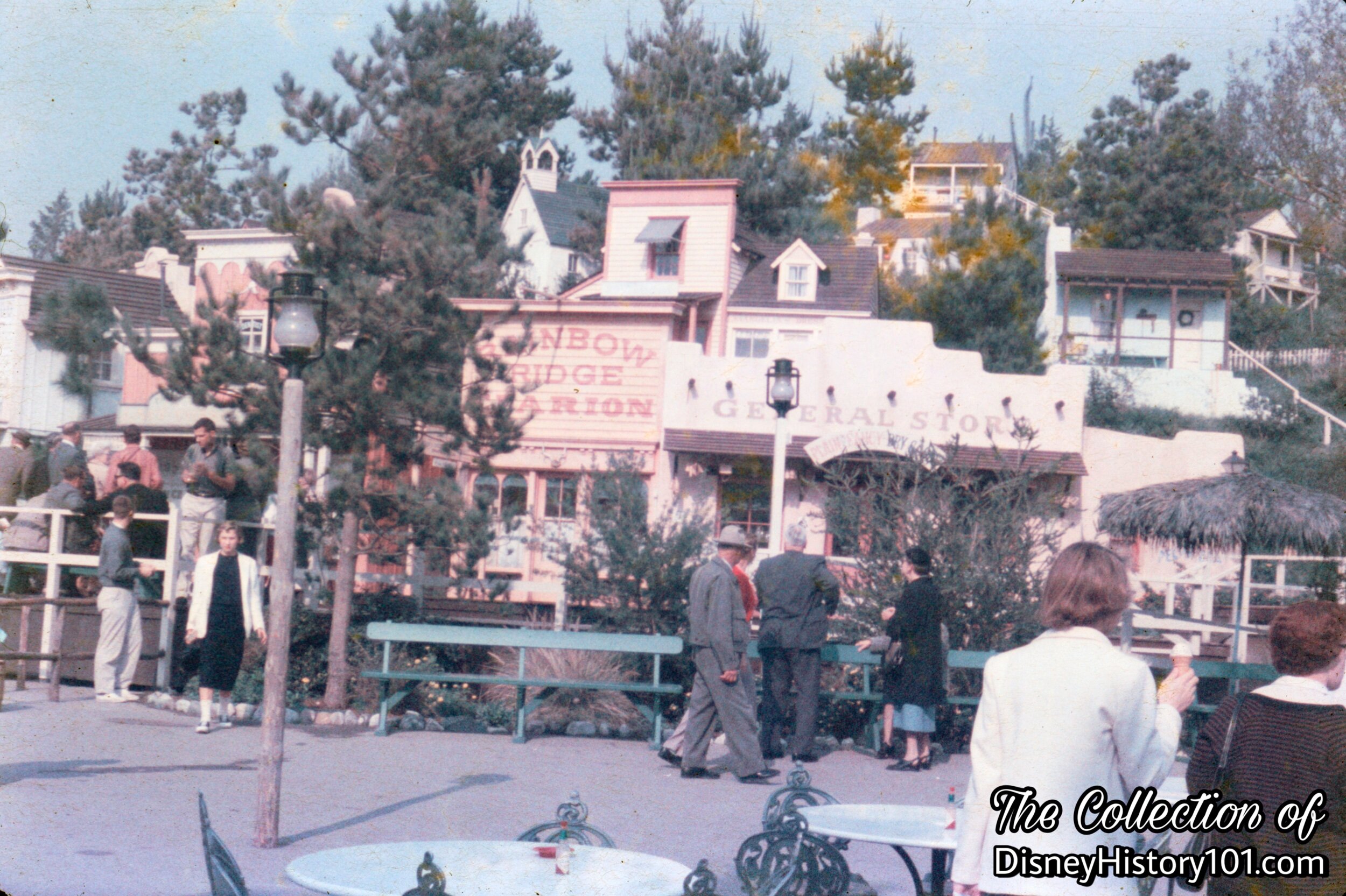
The Town was built in miniature with forced perspective on the side of Rainbow Mountain.
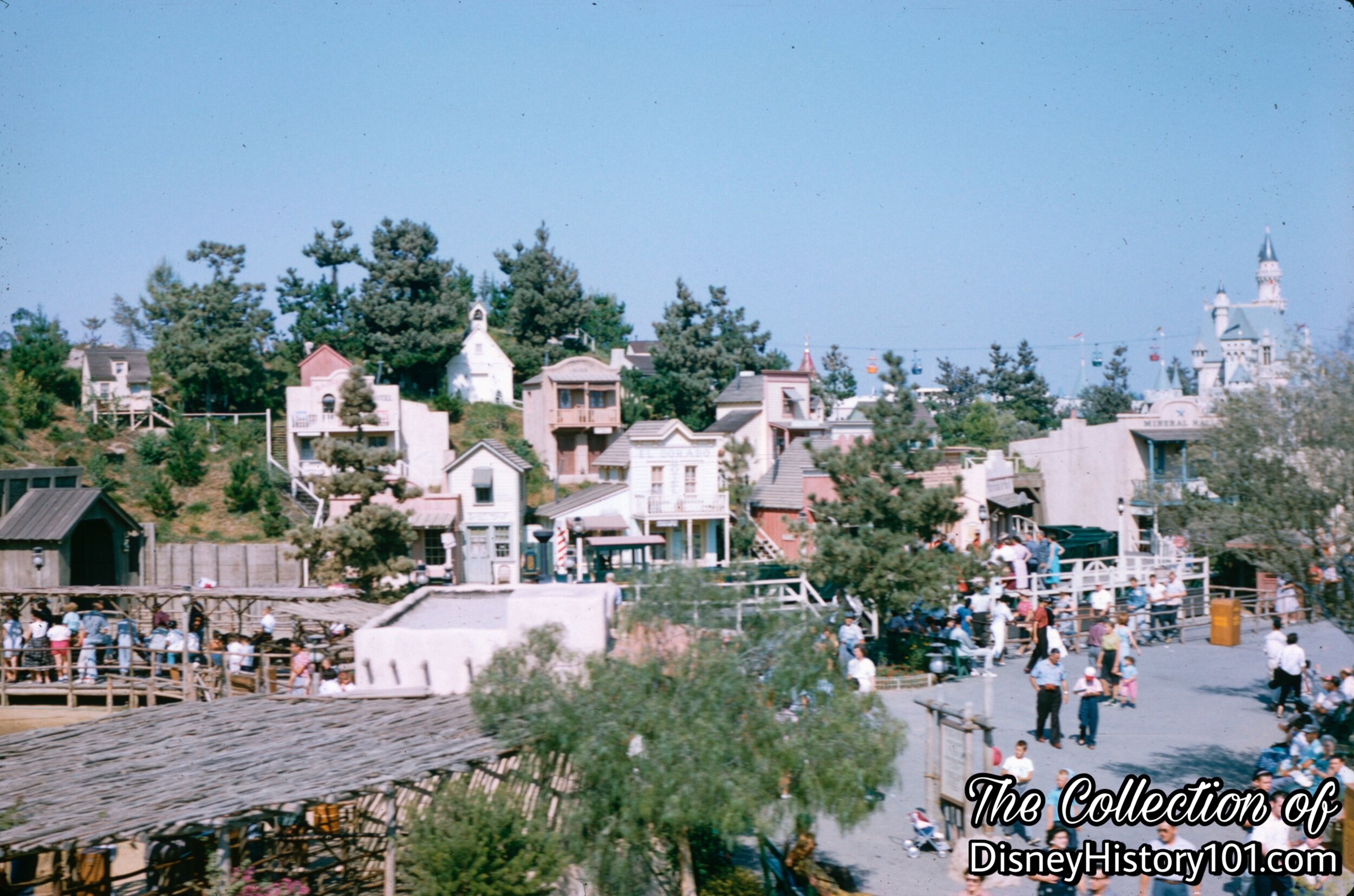
The Rainbow Caverns Mine Train was one of several exciting attractions debuting during 1956, that increased ride capacity (with all it’s gondolas). By the release of the “Disneyland 1st Anniversary Souvenir Pictorial,” it was reported that “new rides have added some 40 percent to the Park’s ride capacity,” listing “the Rainbow Caverns ride” among the contributors. Owing to this, one day in August of 1956 saw a peak total of “197,547 individual rides” enjoyed by Guests (according to a letter from Walt to Ward Kimball, dated January 23, 1957).

Our “tickets for today’s adventure”, and a rare view of the magnificent Rainbow Caverns tickets (pictured above), come courtesy of collector and historian James Keeline. Further, James is “just the ticket” when it comes to the facts about these rare Rainbow Mountain attraction admission tickets!
What were the earliest Disneyland tickets like?
“In the first few years of Disneyland the tickets sold inside the park were often for specific attractions. There were also tickets sold, perhaps at a later date, with A-B-C-D-E.”
What was the original price of one admission to the “Rainbow Caverns”?
“We can fine tune it by noticing the adult price…on the ticket…(50¢). The price stayed the same for a few years but the lettered individual tickets started to appear in this era too.”
Why are these (previously pictured) tickets labeled ‘Rainbow Caverns’?
“The region was initially called the ‘Painted Desert’ [in 1955]. It was redeveloped to add the Mine Train and the name became the ‘Rainbow Desert.’ The desert portion was called the ‘Living Desert’ for the Nature's Wonderland era.”
What do those punched holes (in the previous photo) indicate?
”The hole in each ticket was part of the distribution mechanism. ‘VOID’ was used when they wanted to have tickets to put on display in the park ticket booths if people wanted to trade them in towards passports, etc.”
Later, admission during 1958 was one “jumbo” “D” coupon (the price of 35 cents, for one child), the same as the Jungle Cruise, Indian War Canoes, or the Tom Sawyer Island Rafts.
Ticket inspectors - you’ve got to hand it to them! After you hand your ticket to them, they place it in the Ticket Box. The Ticket Box was usually made of fiberglass or metal and supported a ticket bag or container, and in which torn admission coupons are de-posited. The Ticket Bag was a canvas liner of a ticket box used to collect torn admission coupons. The Ticket Container was a plastic container which fit inside a ticket box (in place of a ticket bag) and was used to collect torn admission coupons.
Our Rainbow Caverns tickets will be taken by the Ticket Receptionist, on the Rainbow Ridge Boarding Platform, before embarking on our journey.
People like Dick Tryon (Manager of Ticket Sales, 1955-59) would have somewhat familiar with these tools and procedures.
Now, we’re ready to “get back on track” and take a ride!
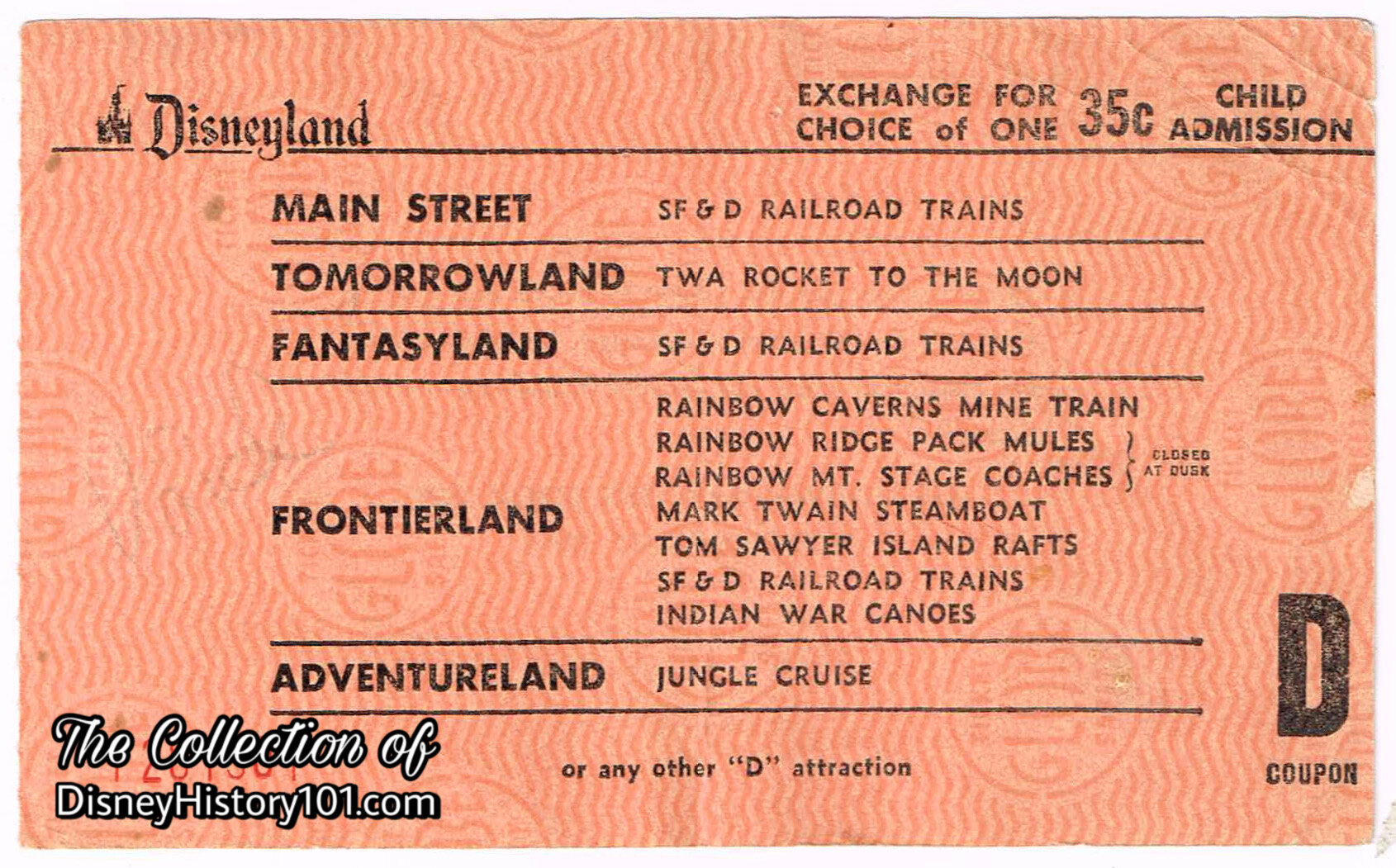
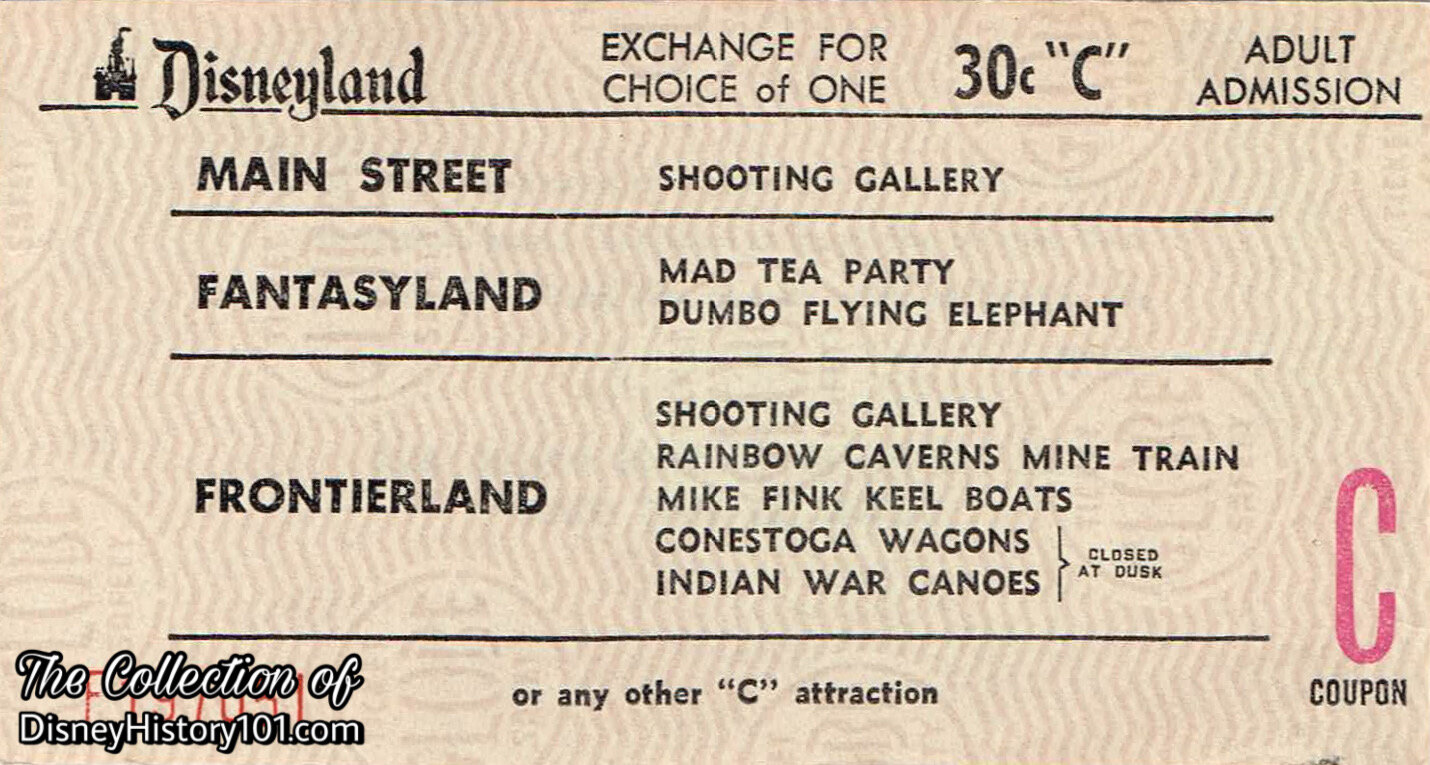
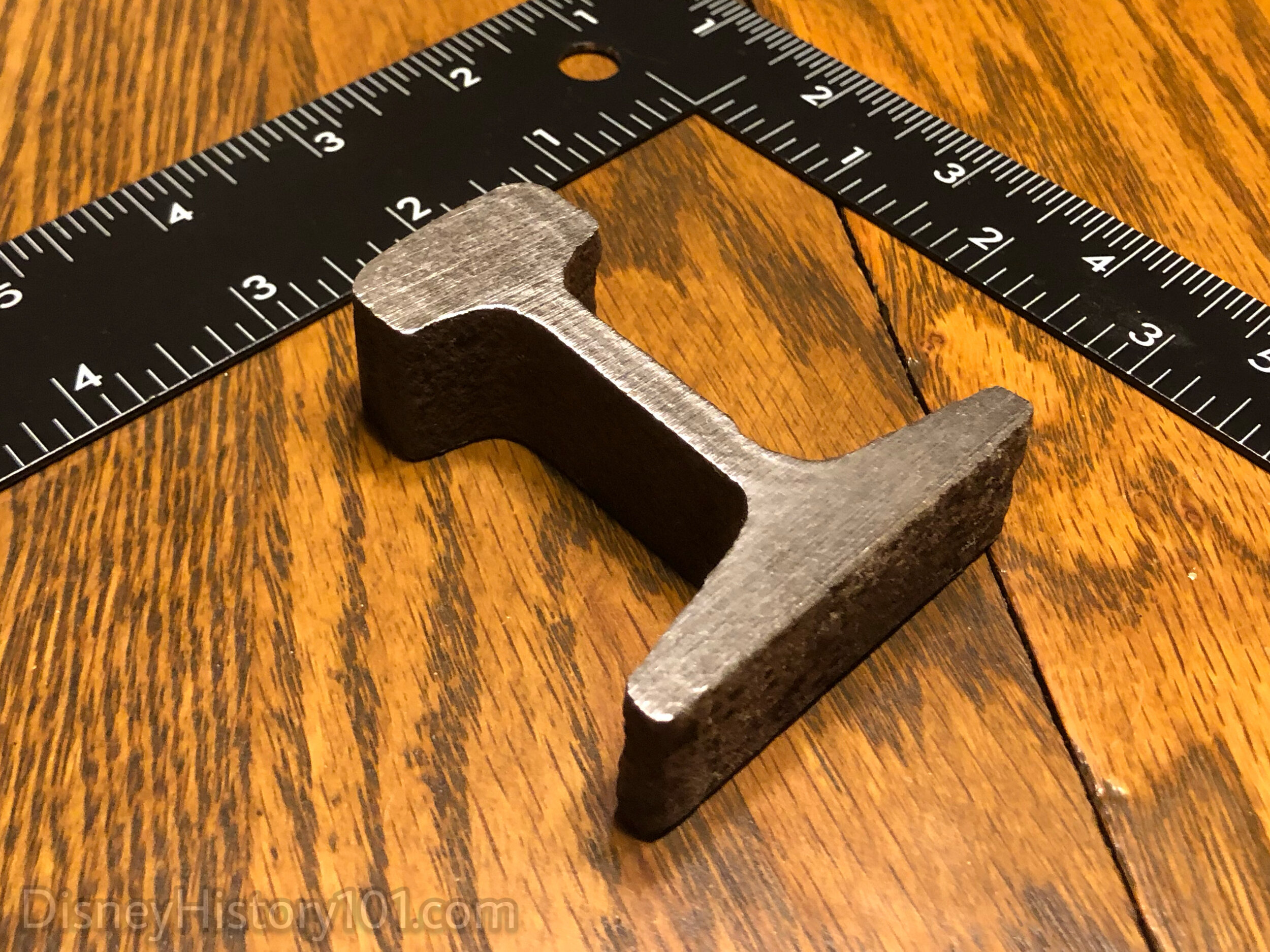
Can you believe that 30” rail similar gauge to the one pictured, supported the weight of those mine trains and gondolas that ran thru the Painted Dessert (and the rest of Nature’s Wonderland)? The weight of the rails was roughly 20 pounds per yard.
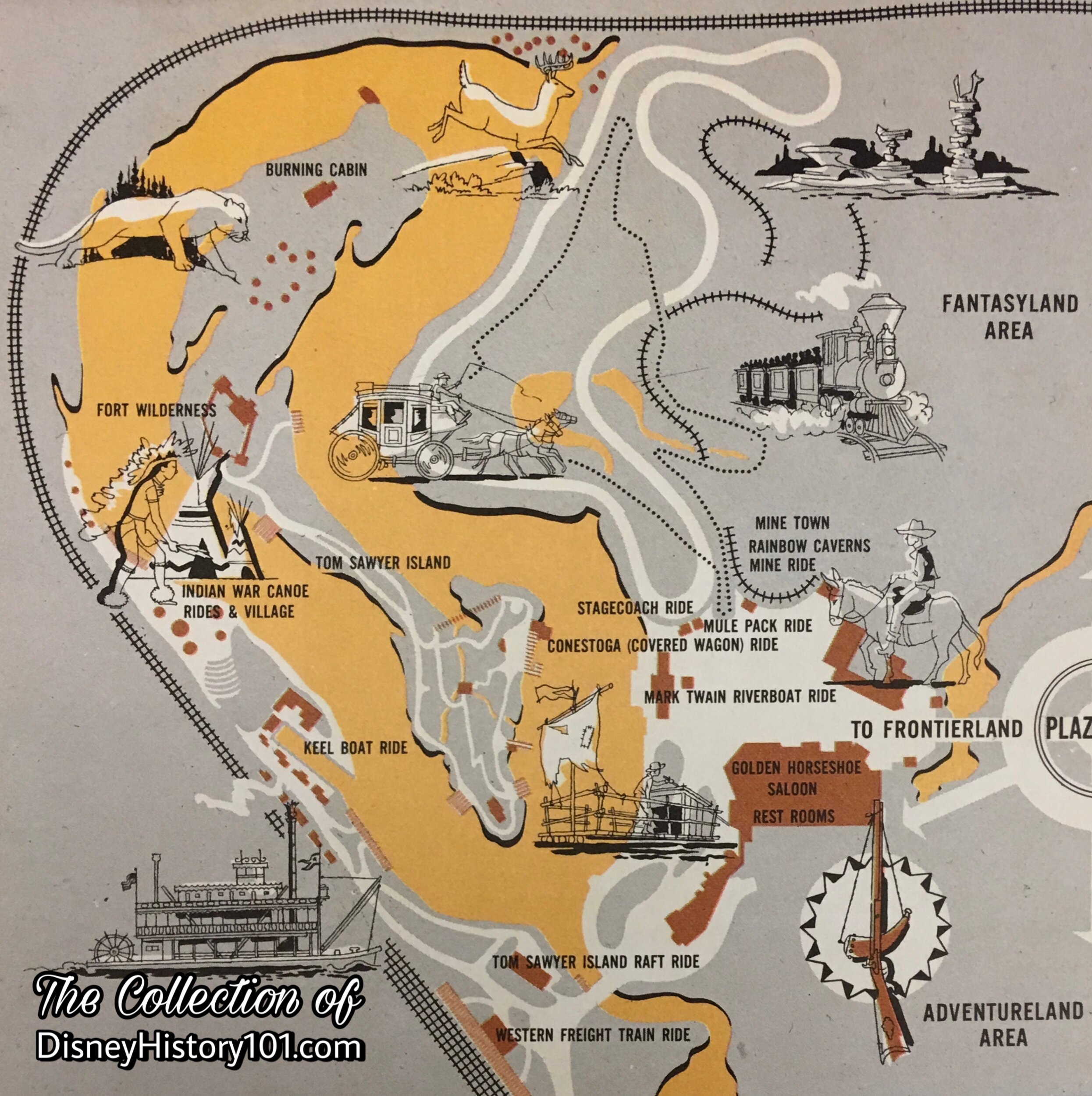
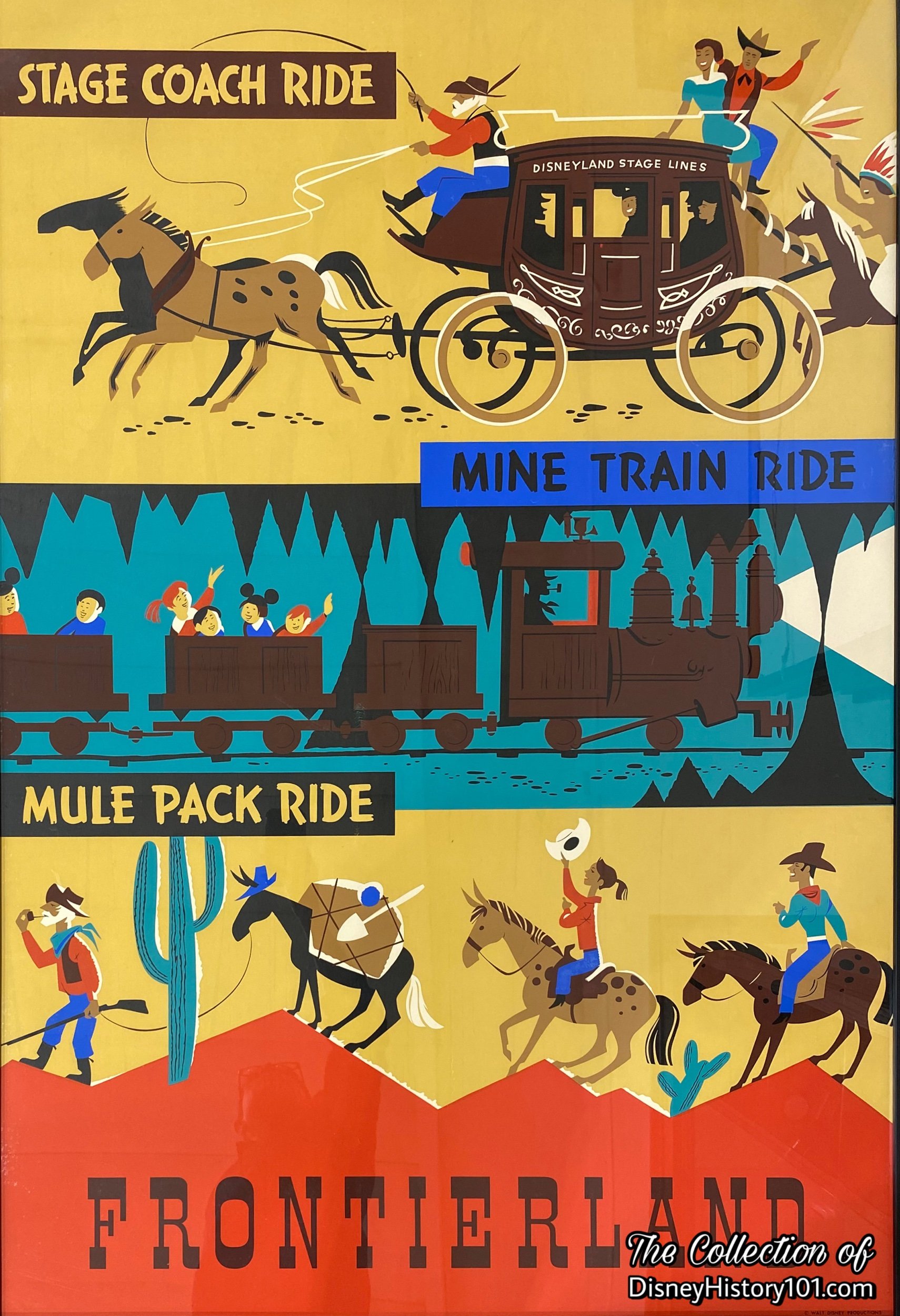
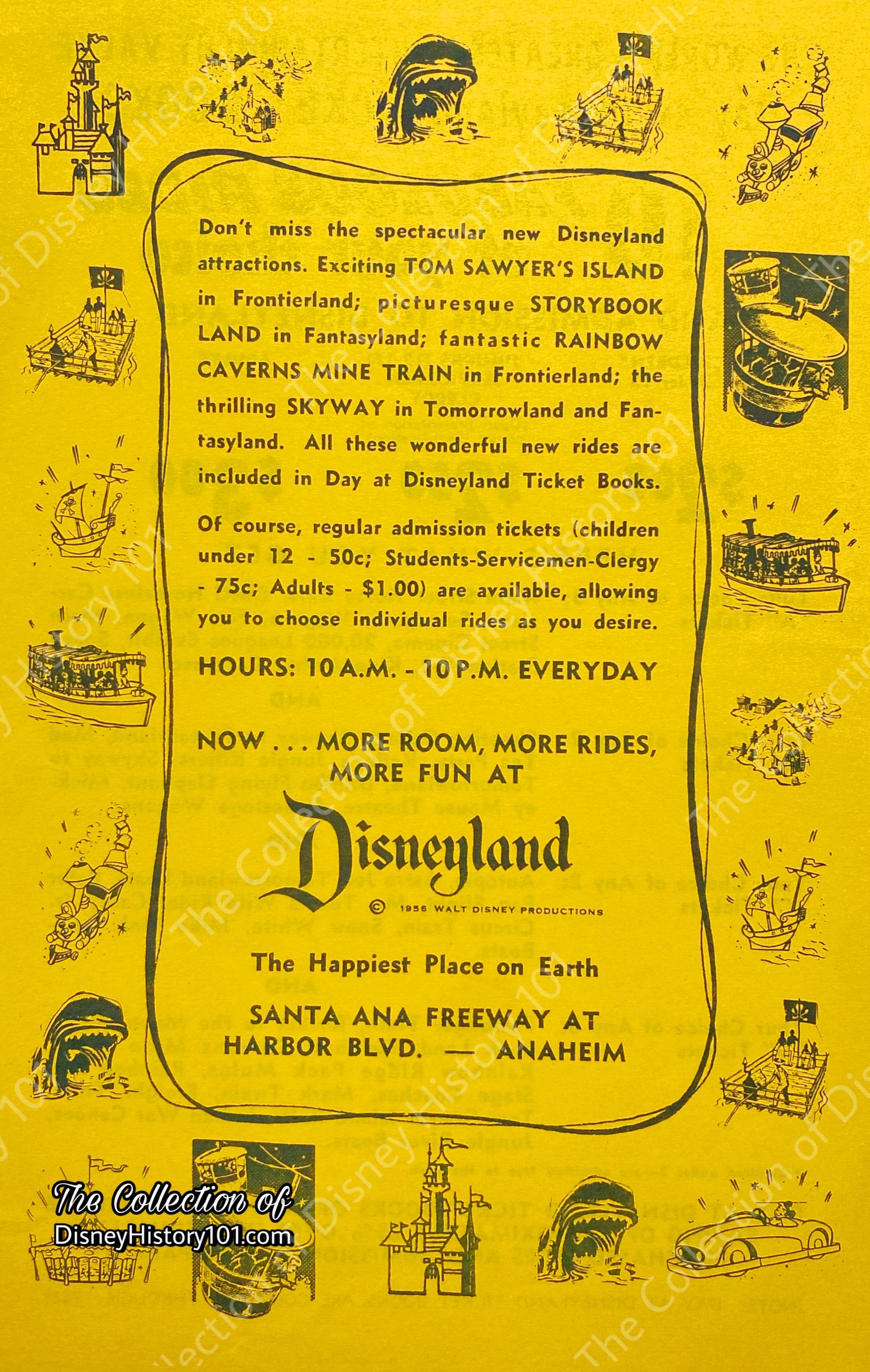
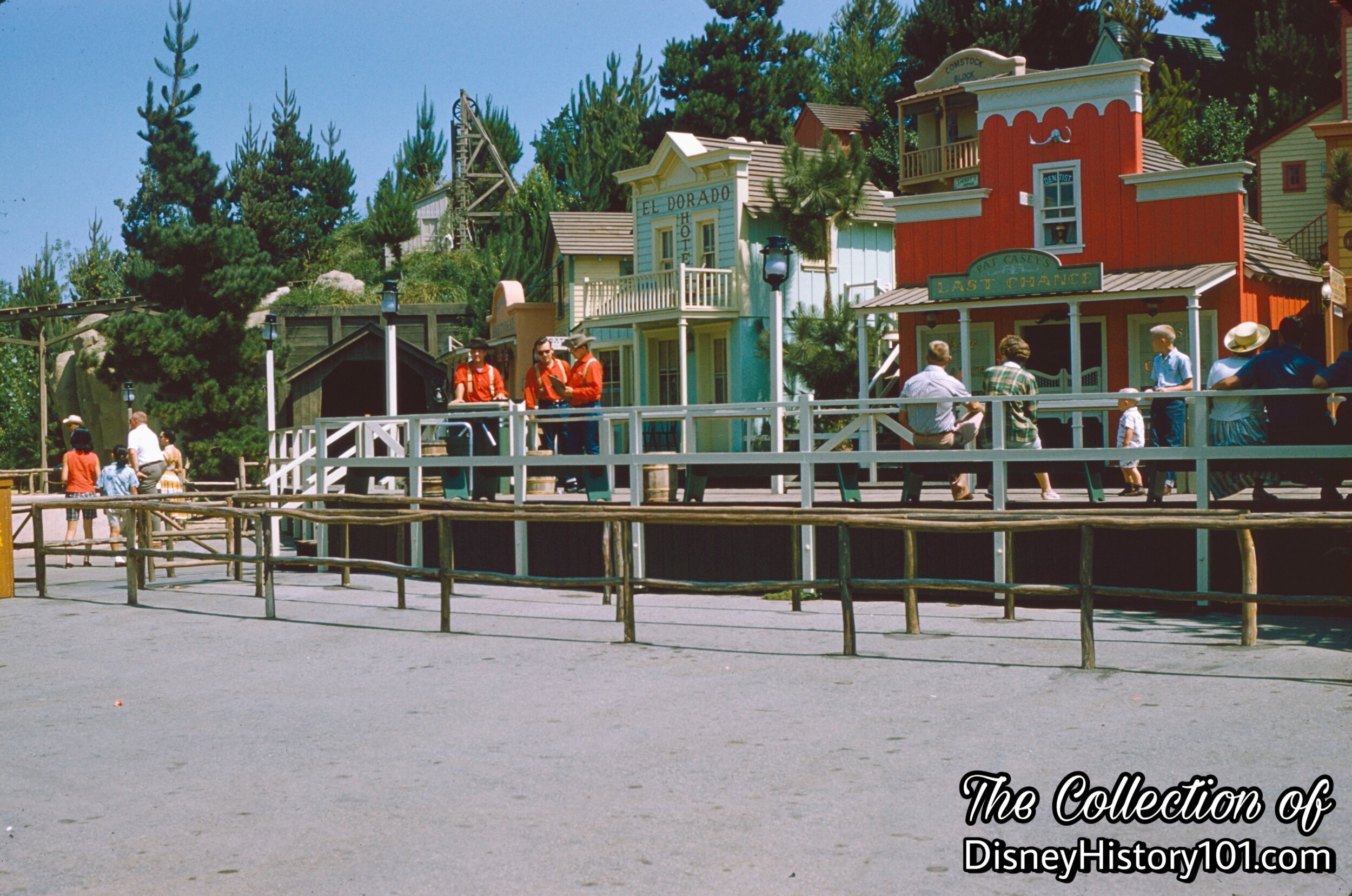

Guests board the dark green gondolas.
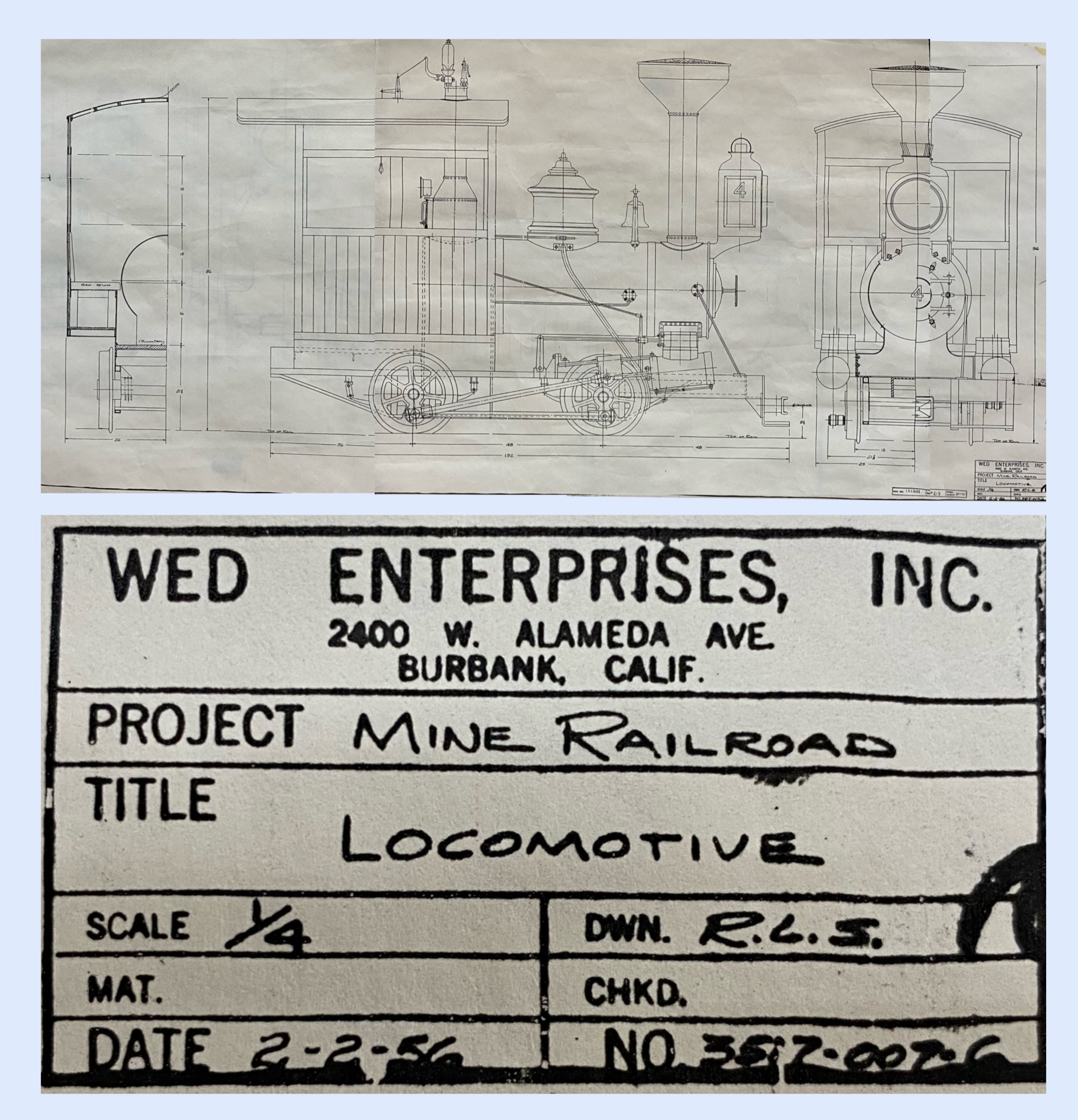
The Rainbow Mountain Mining & Exploration Co.
(Mine Ride-Frontierland) had two engines. Each engine was designed and built at the Walt Disney Studios under the supervision of machinist Roger Broggie, Jr. (who understood narrow gauge railroads, because he had his own at home and helped fabricate Walt Disney’s Lilly Belle engine)!
Mine Train historian James Keeline shares some of the likely inspiration for these iconic locomotives :
“The locomotive that is the most likely inspiration for the Mine Train was the 0-4-2 called the Joe Douglass. It was used to help build the dam at Lake Arrowhead. Afterward it was left as a static display. The Broggie family notes that they visited this. It was moved at some point to the La Paz guest ranch in Palm Springs, CA. It is possible that Walt Disney saw it there during one of his visits to his property on Smoke Tree Ranch which was nearby. The locomotive was later donated to the Nevada State Railroad Museum in Carson, NV. The similarity in shape and the connections with the Broggie family, and perhaps Walt, make this the most likely inspiration when the Mine Trains were being designed.
The particular design of the locomotives was a little different from what was normally used. Typically, a small "pony engine" would have a saddle tank over the boiler….Note that Big Thunder (and the Calico Mine Train) use saddle tank versions….There was a family member of someone whose father worked for Mancha (later Goodman) who supplied the electric mining locomotives which were used.”
Each engine was powered by 530 amp electric batteries.
Each engine had a capacity of 64 Guests.
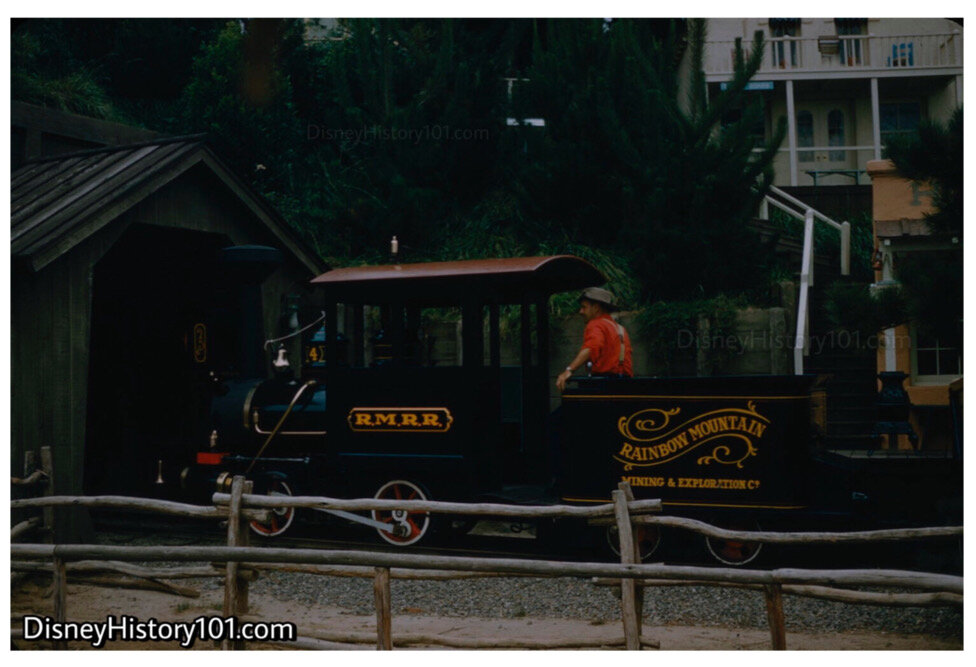
Originally (from 1956 to 1959), dark green locomotives (powered by 530 amp electric batteries) pulled the open ore cars of Rainbow Mountain Mining and Exploration Company. These transported a capacity of 64 Guests through the Painted Desert and mother-lode country of the old West, through Rainbow Caverns with its multi-colored fountains and falls.
“The climax for the ride was the trip through Rainbow Caverns. However, to give it more of a reason to be there, they came up with the name ‘Rainbow Mountain’ to describe the area where the mine (and Rainbow Caverns) was located.”
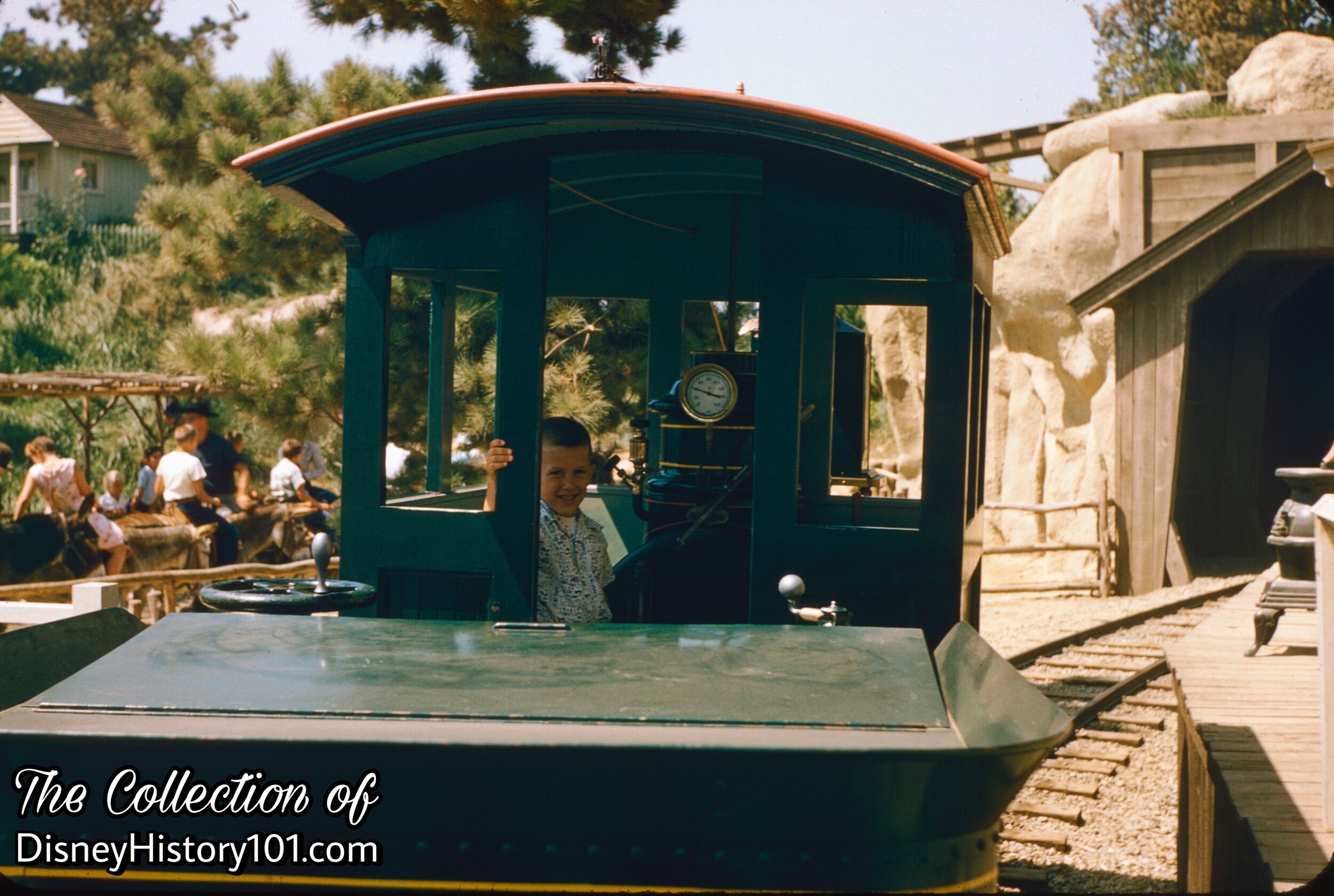
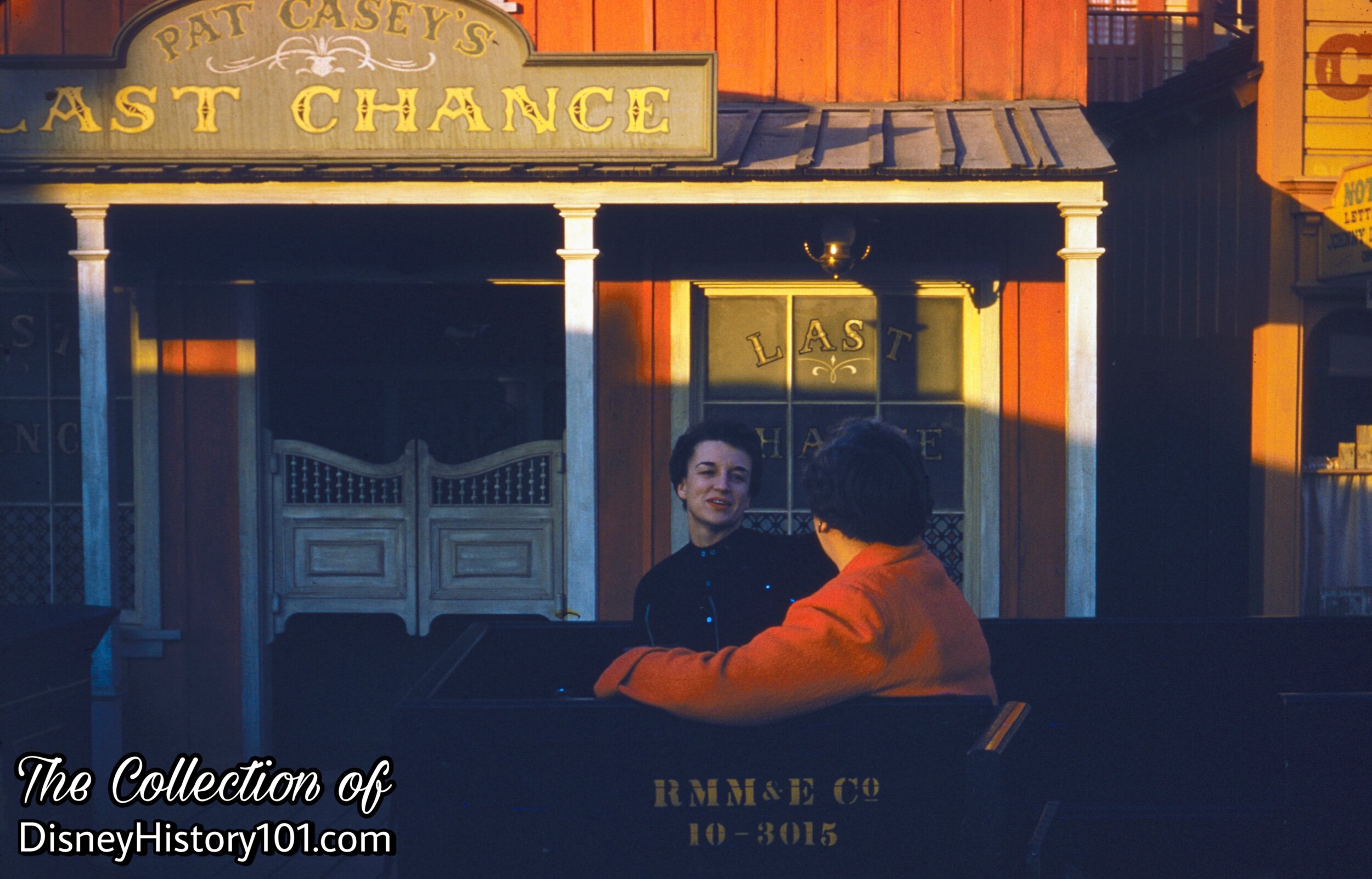
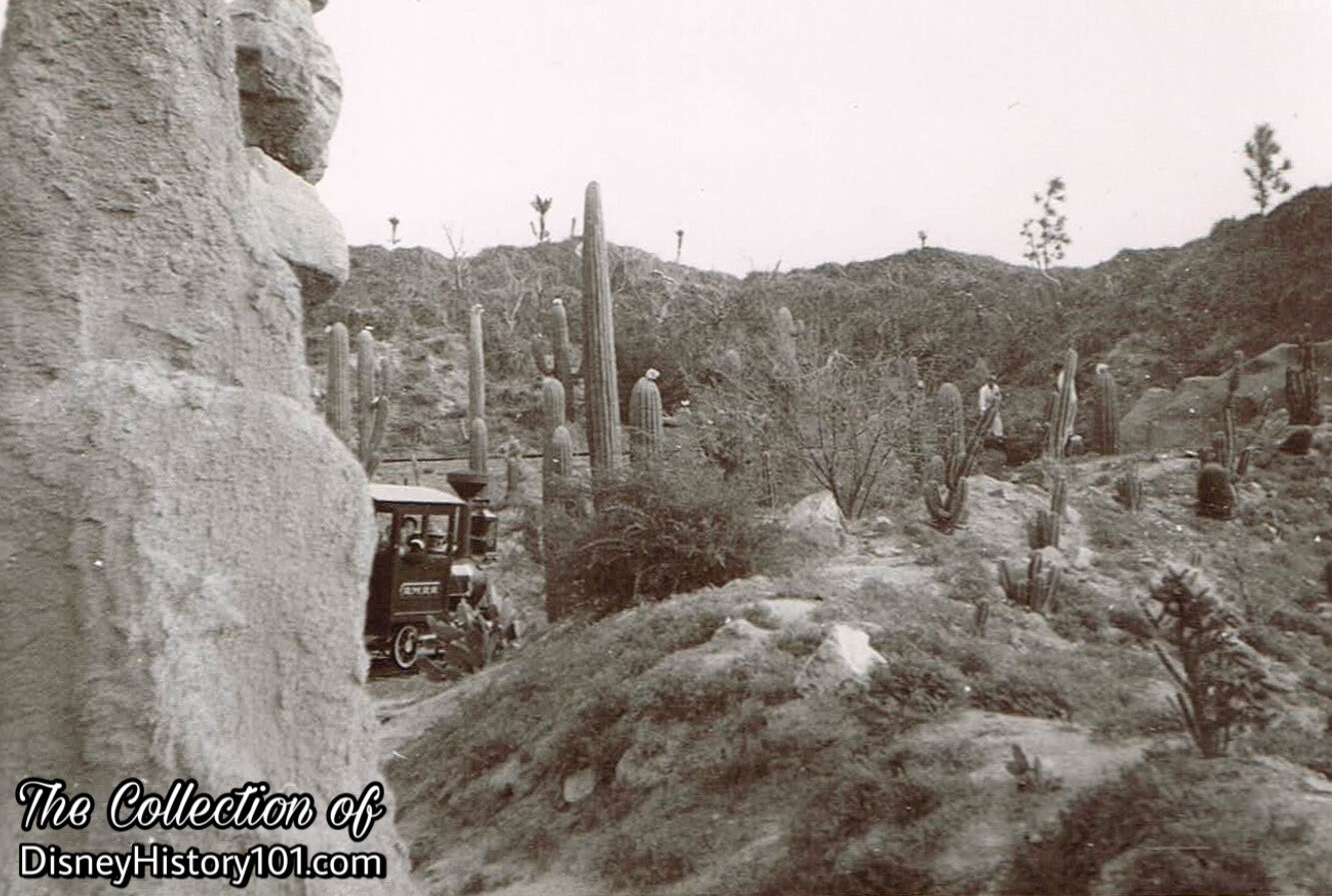
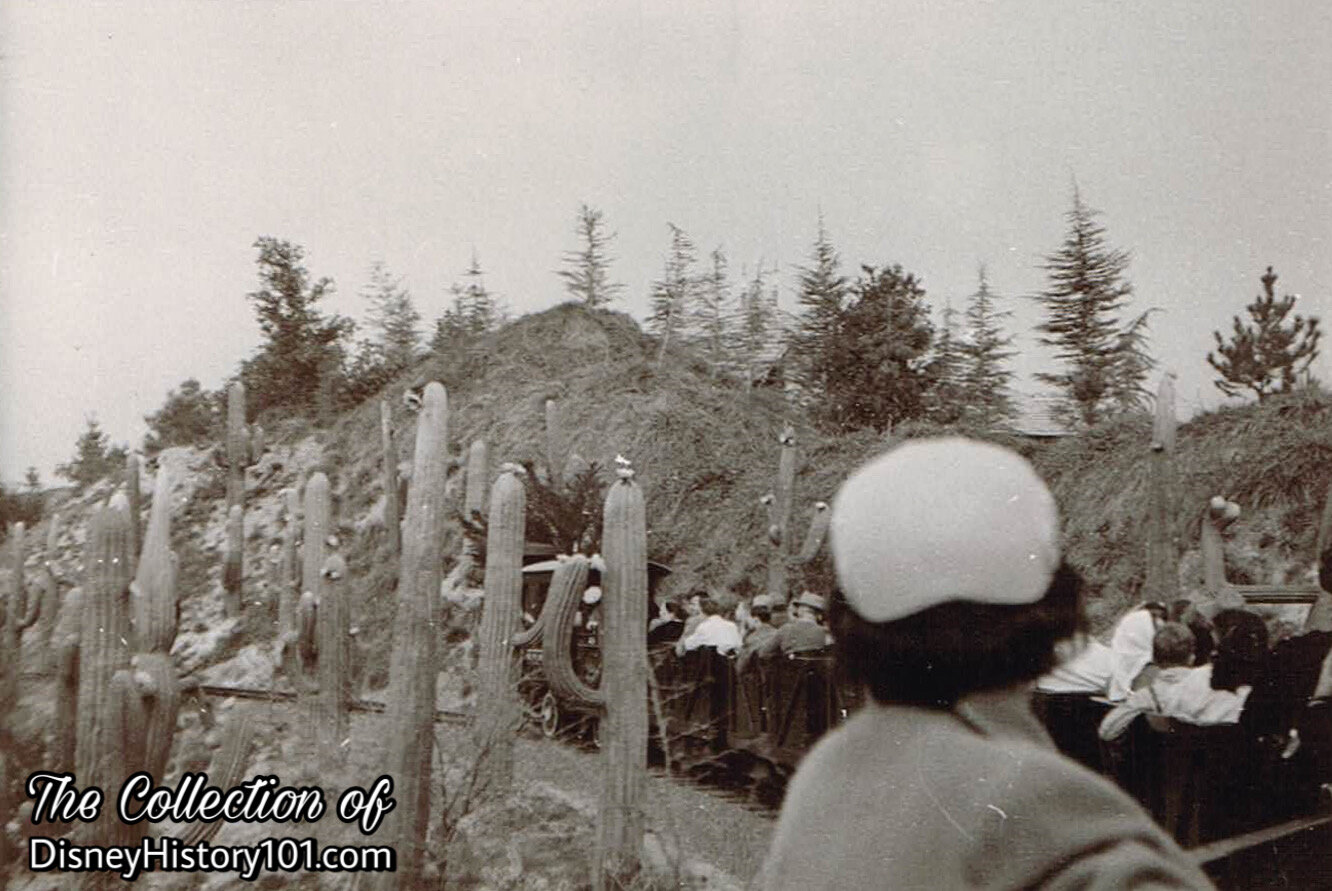

Even in these early days, the desert heat was known to “get” to guests. Sometimes the cacti appear to be “thumbing a ride”, or look like an eight-armed octopus! At times, the bellowing from these old pipe organ cacti sometimes even appear to form symphonies as the desert wind passes through them.
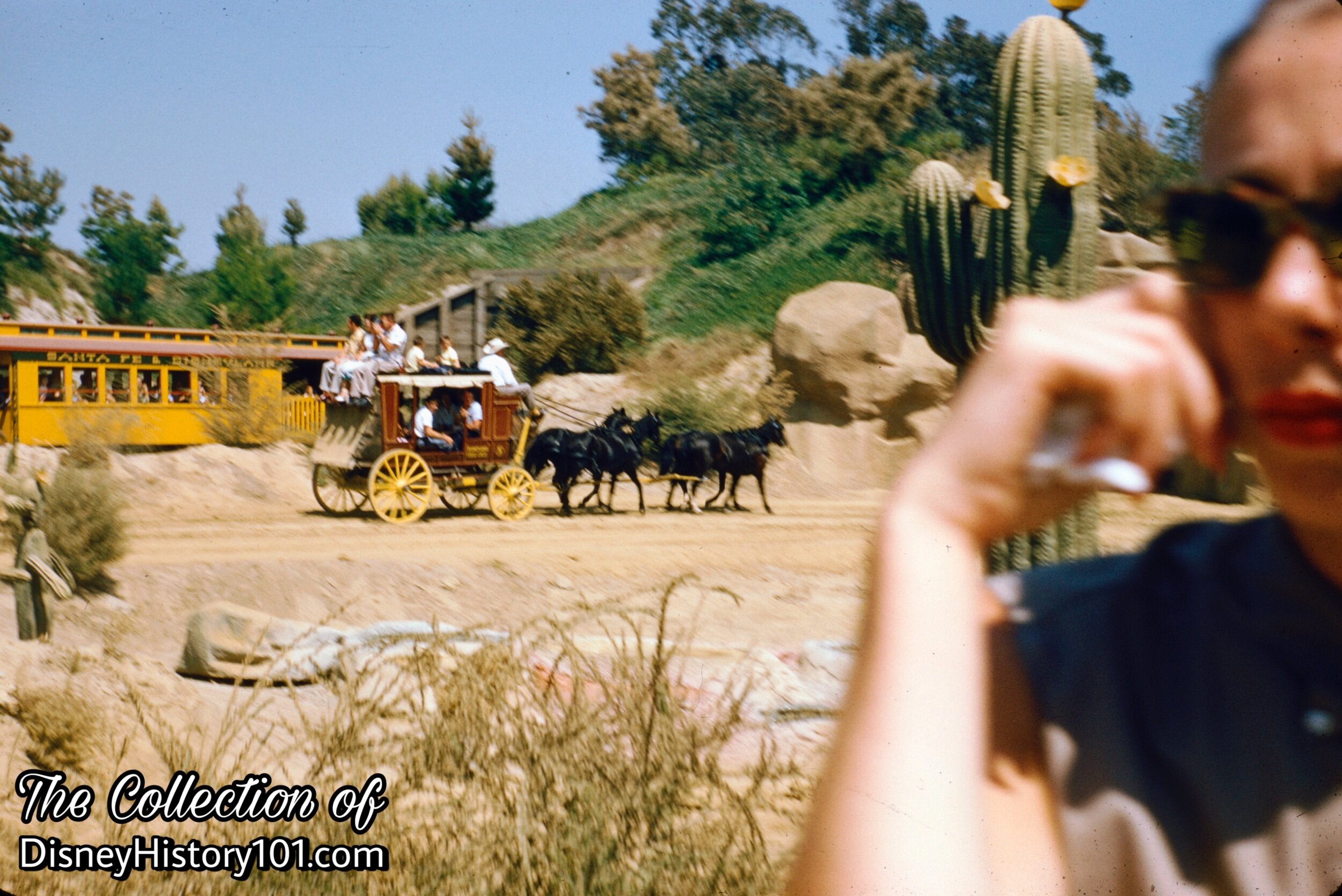
The proximity of multiple paths cut through the Painted Desert (or, “three fabulous ways to enjoy the Painted Desert”) are depicted in this Vintage View!
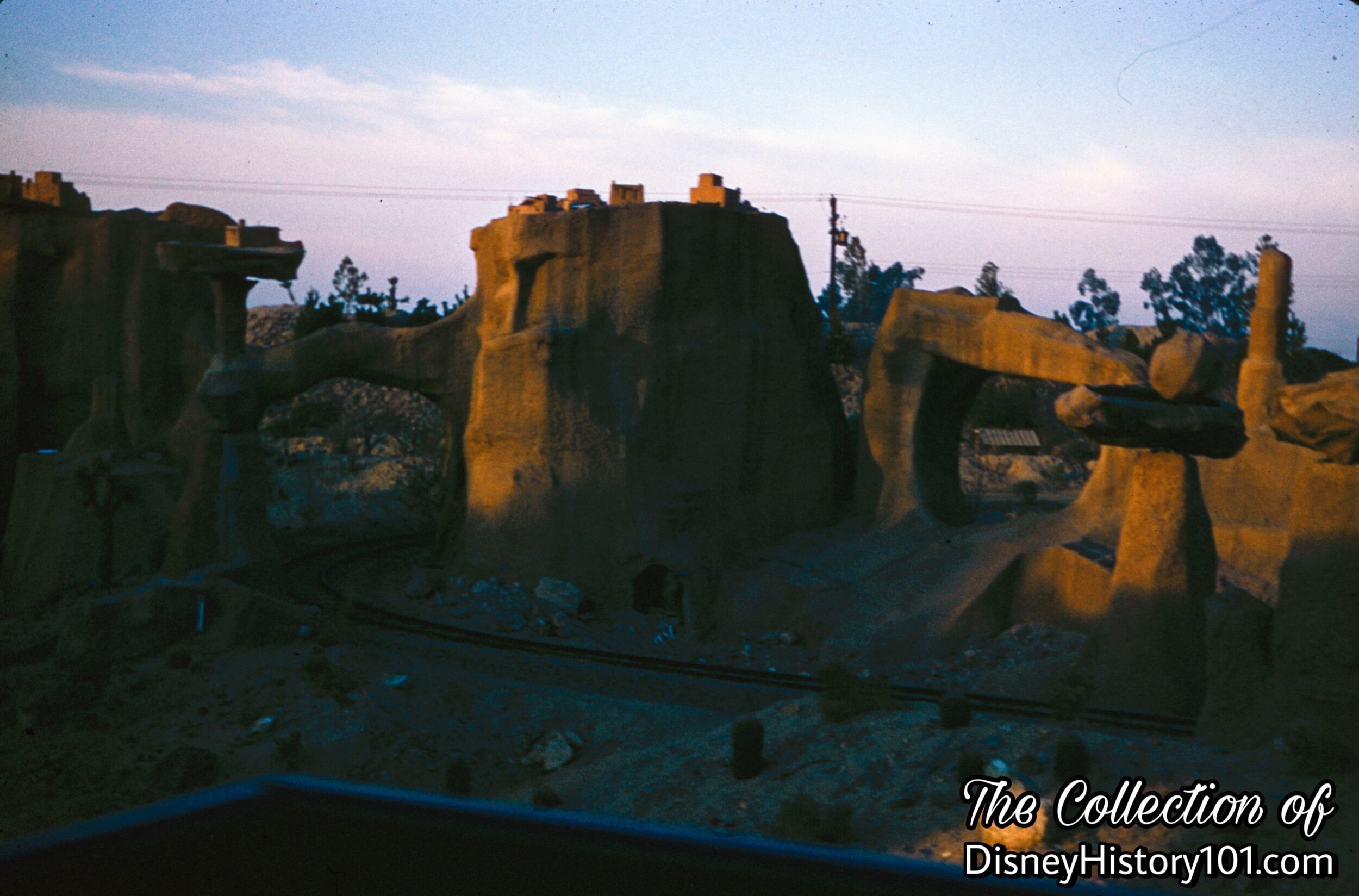
Passing Dead Man’s Spring, we come to Rocky Gorge with such formations as Coyote Rock, Inscription Rock, Elephant Rock, Natural Window Rock, and the Balancing Rocks, “teetering precariously on wind and sand worn points”, according to “News From Disneyland”, a press release published 1956).
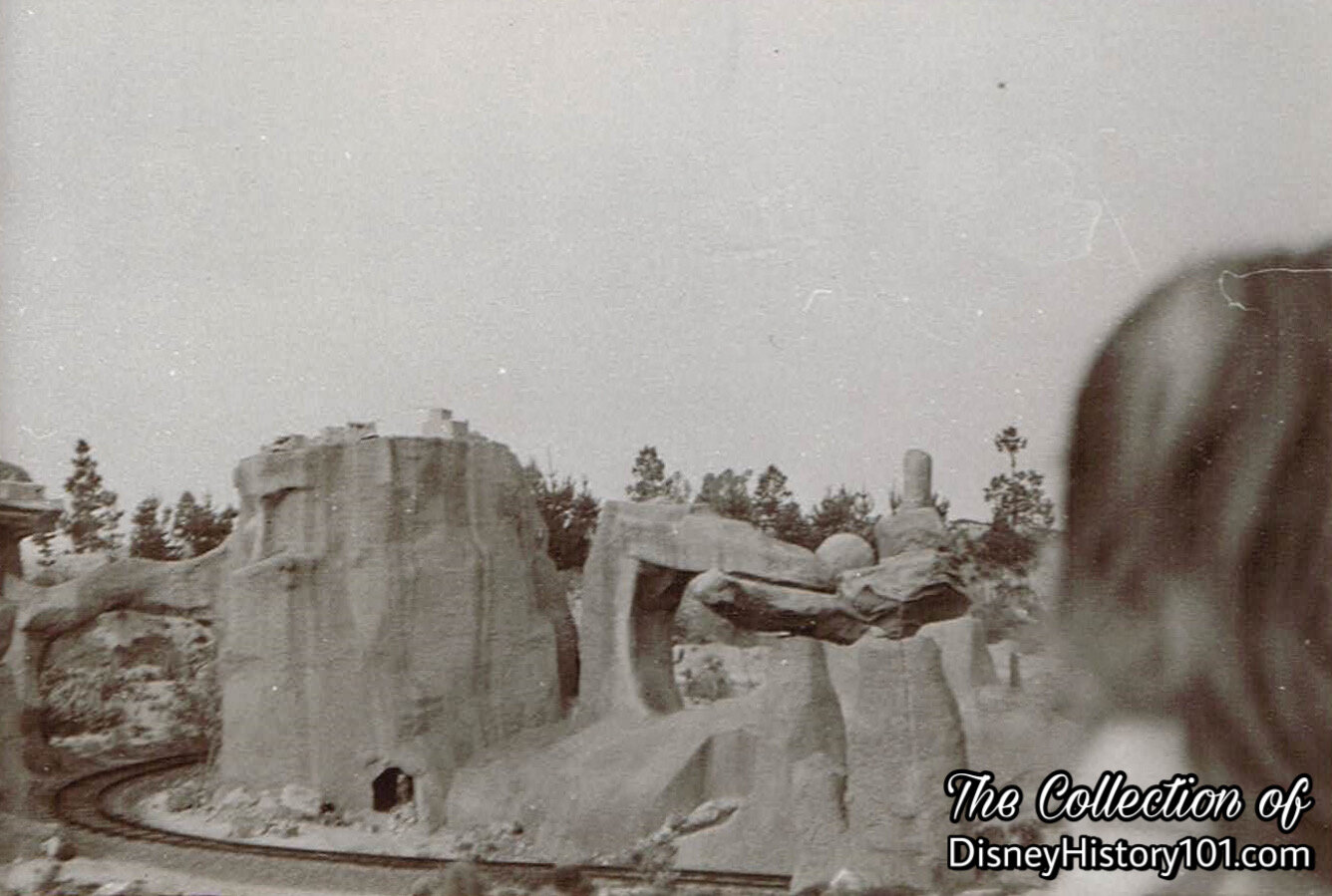
While the tracks run through the shadows of desert canyons (like Horse Thief Canyon), Hopi dwellings can be seen high above the wind-swept cliffs. These stand “in silent tribute to the artistry of an ancient people”.
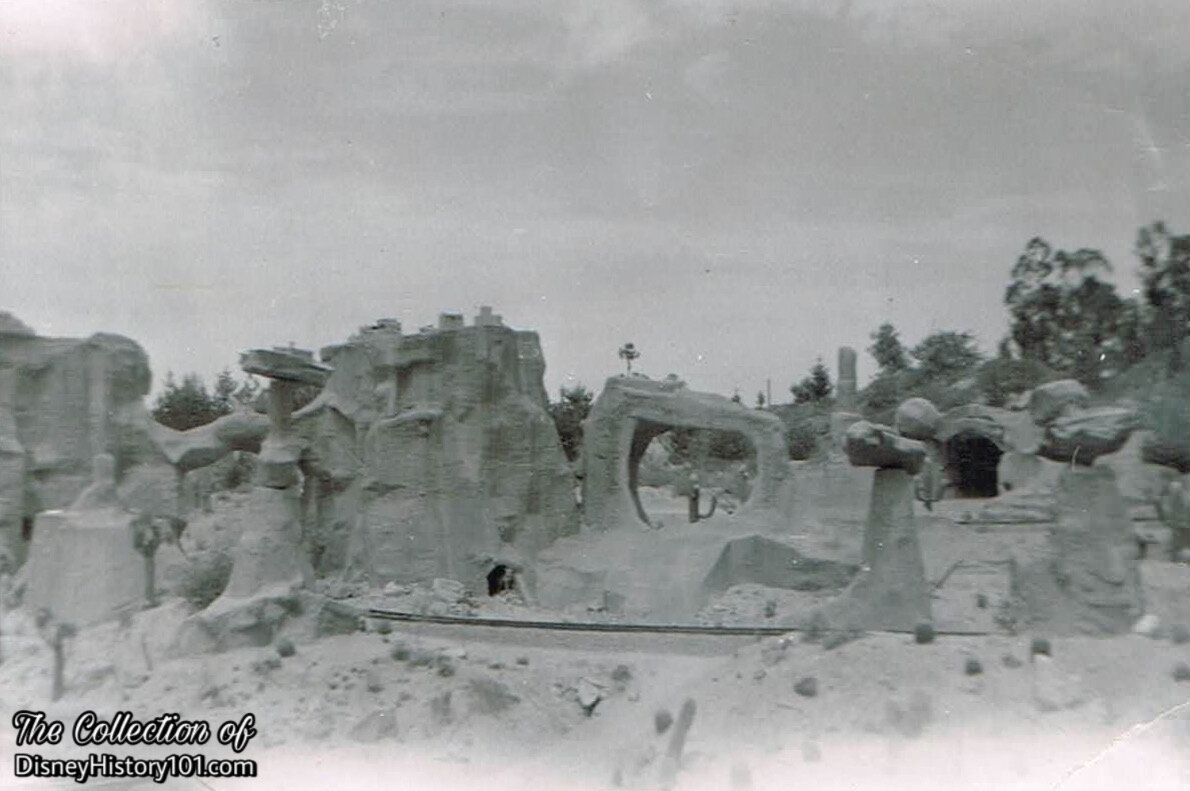
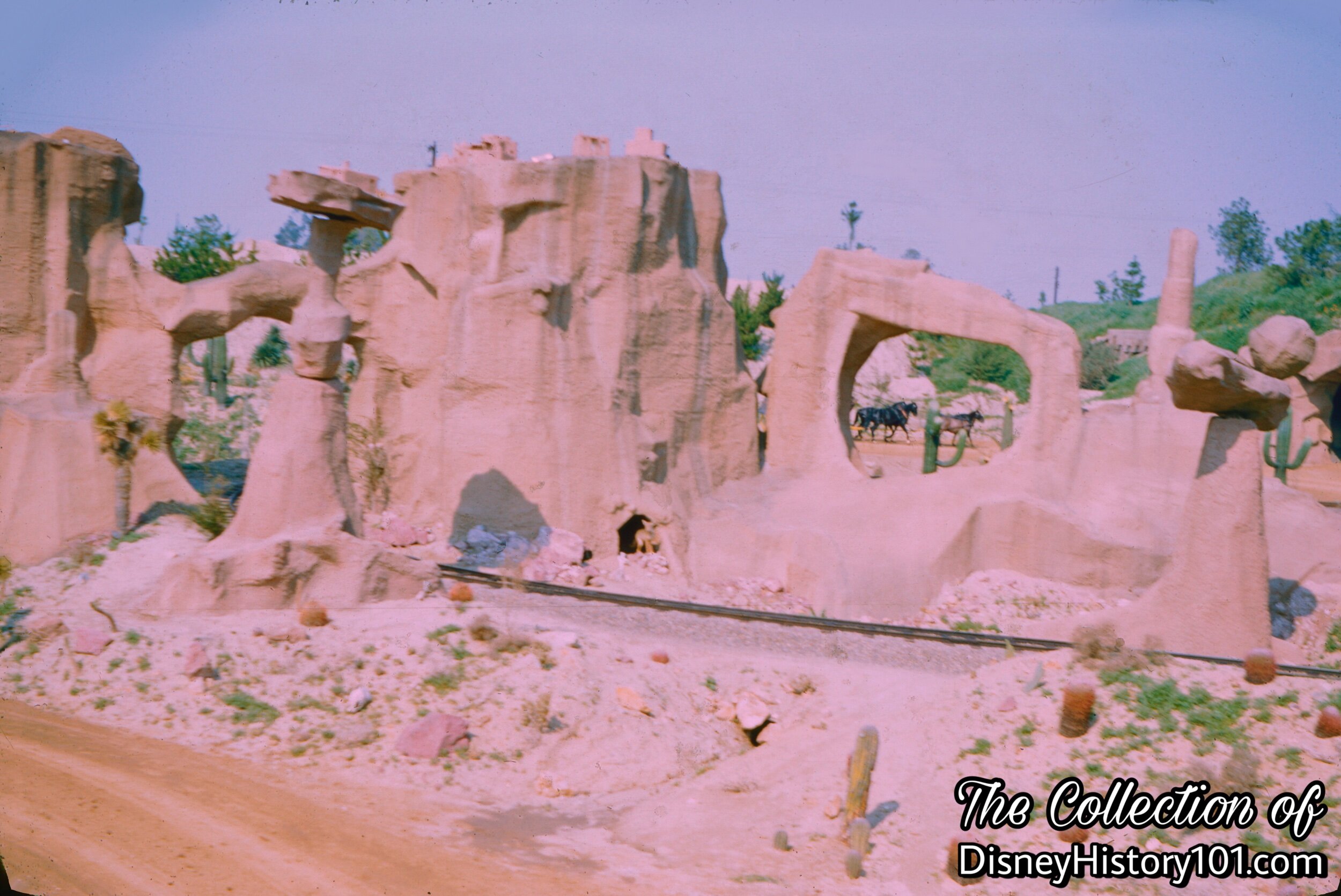
“Now folks, we gotta git through Balancing Rock Canyon!”
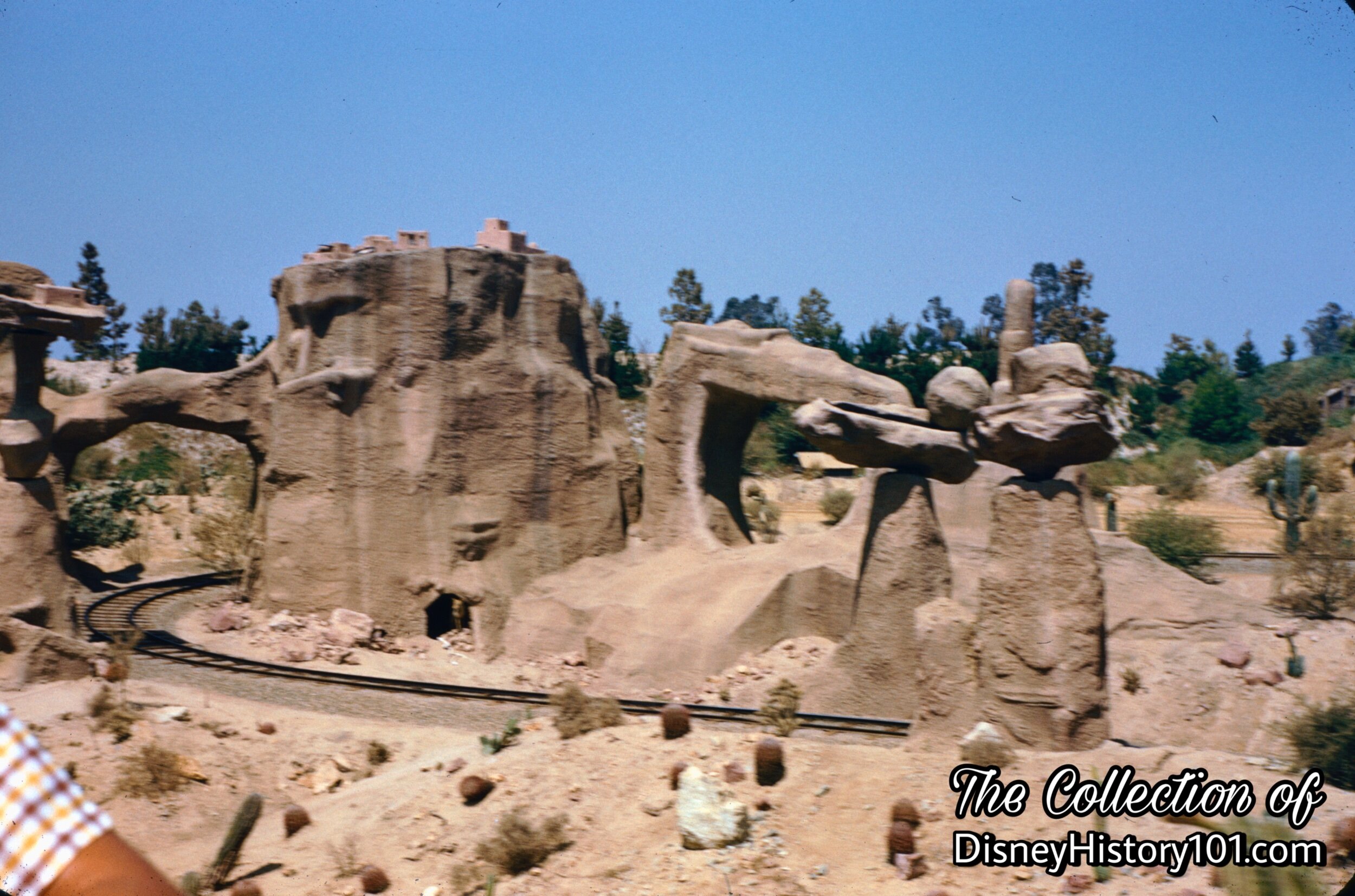
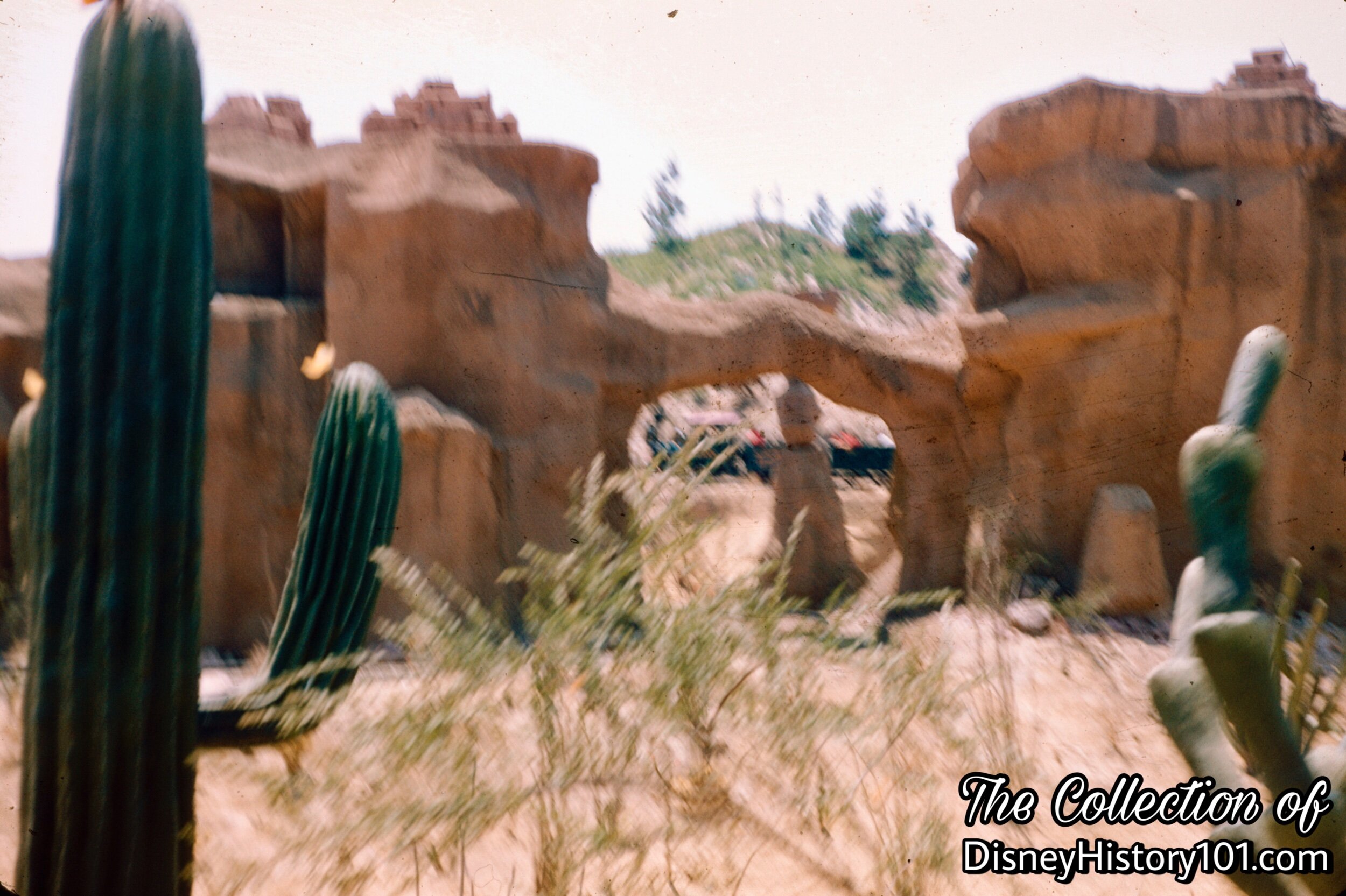

The Rainbow Mountain Mine Train chugs through the desert in this Rainbow Caverns Mine Train Panoramic Postcard Image. We can see Natural Window and Balancing Rock Canyon - two real mysteries of the desert!

This short paragraph (published only months after the Rainbow Caverns Mine Train opened), describes what guests will encounter as they pass through the Rainbow Desert.
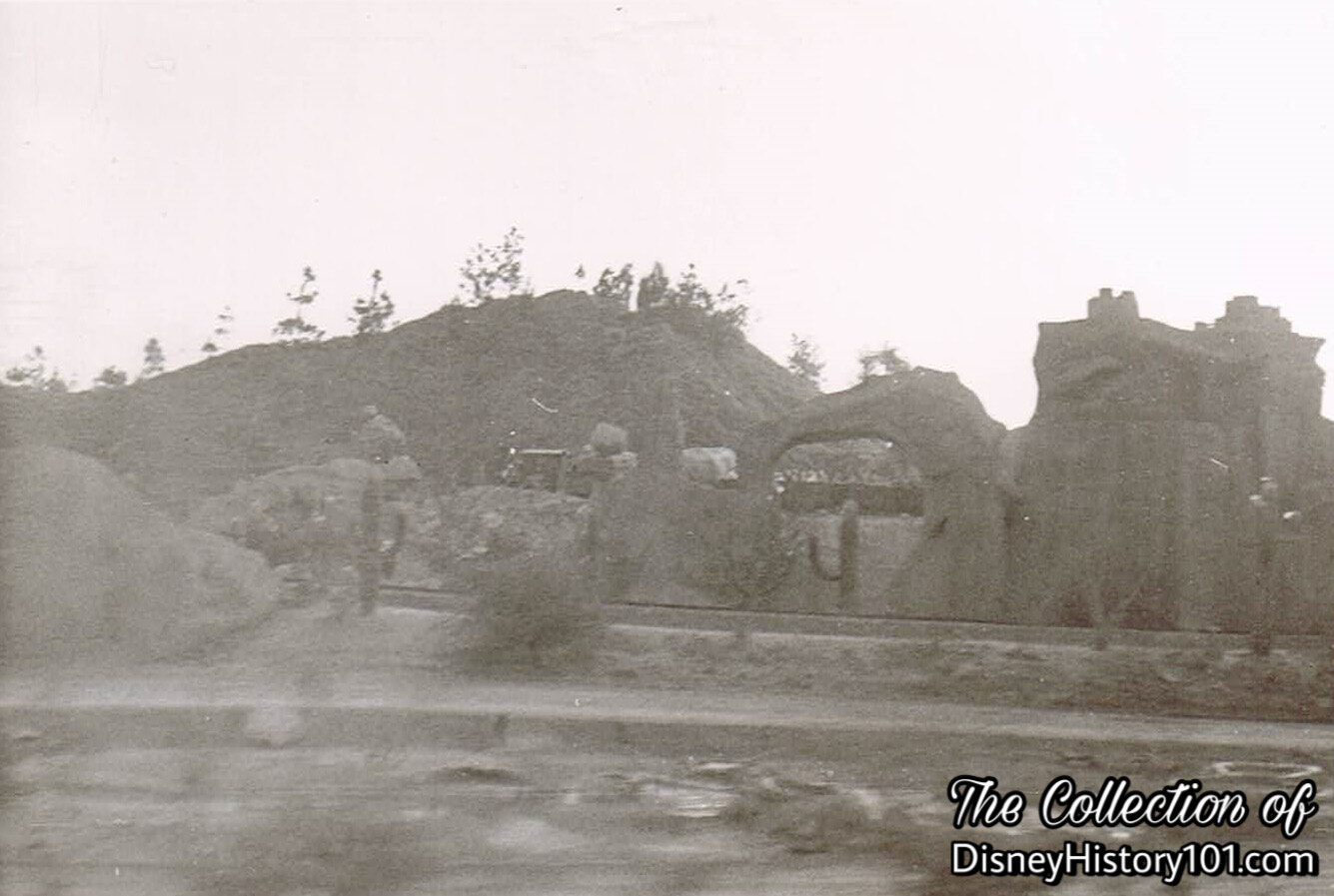
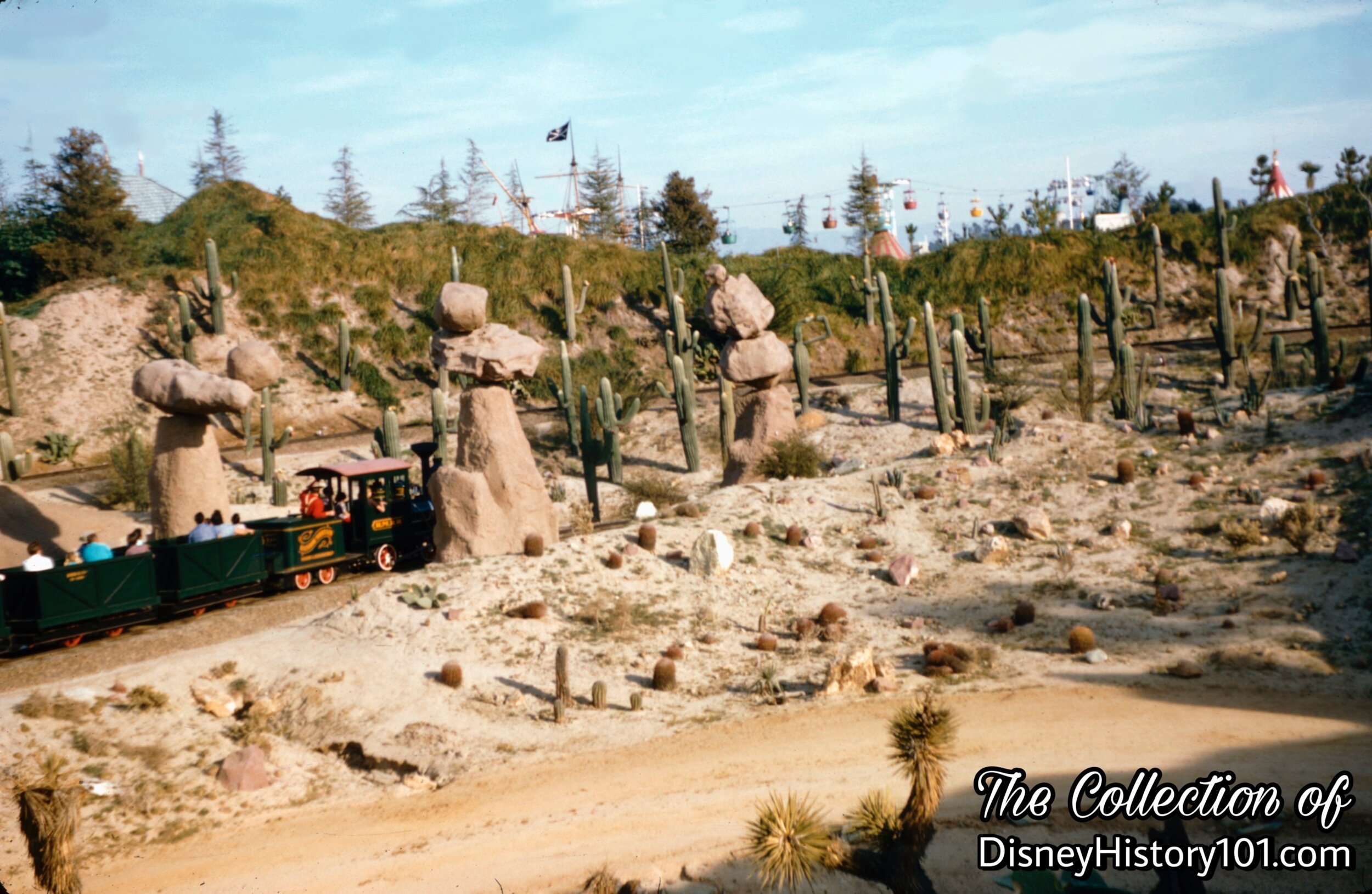
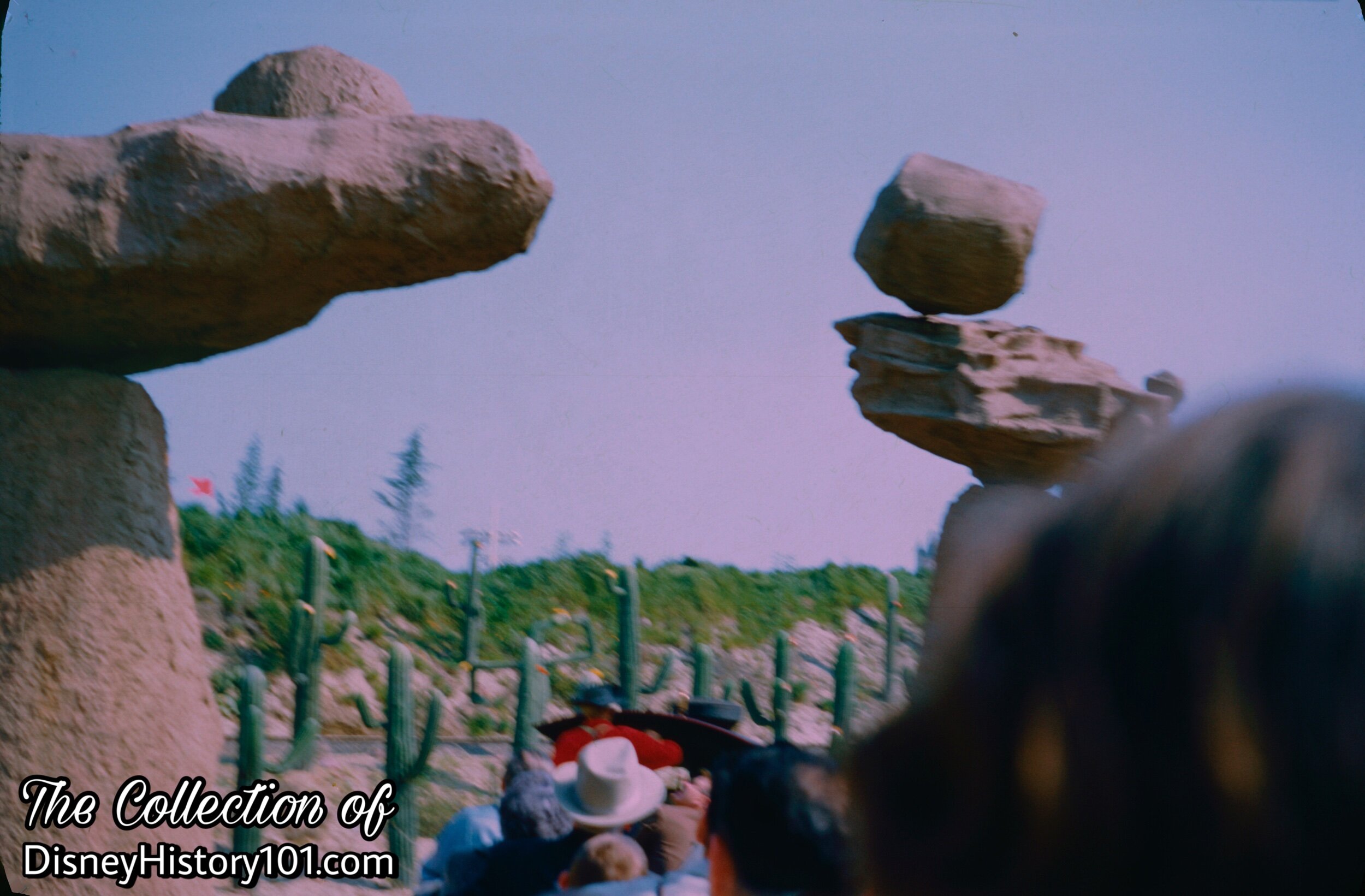
It appears that the vibrations from our whistle have made“these rocks really ‘rock and roll’!” In reality, the sound from our train whistle has tripped a sound actuated switch and motors causing the rocks to tip wildly overhead!
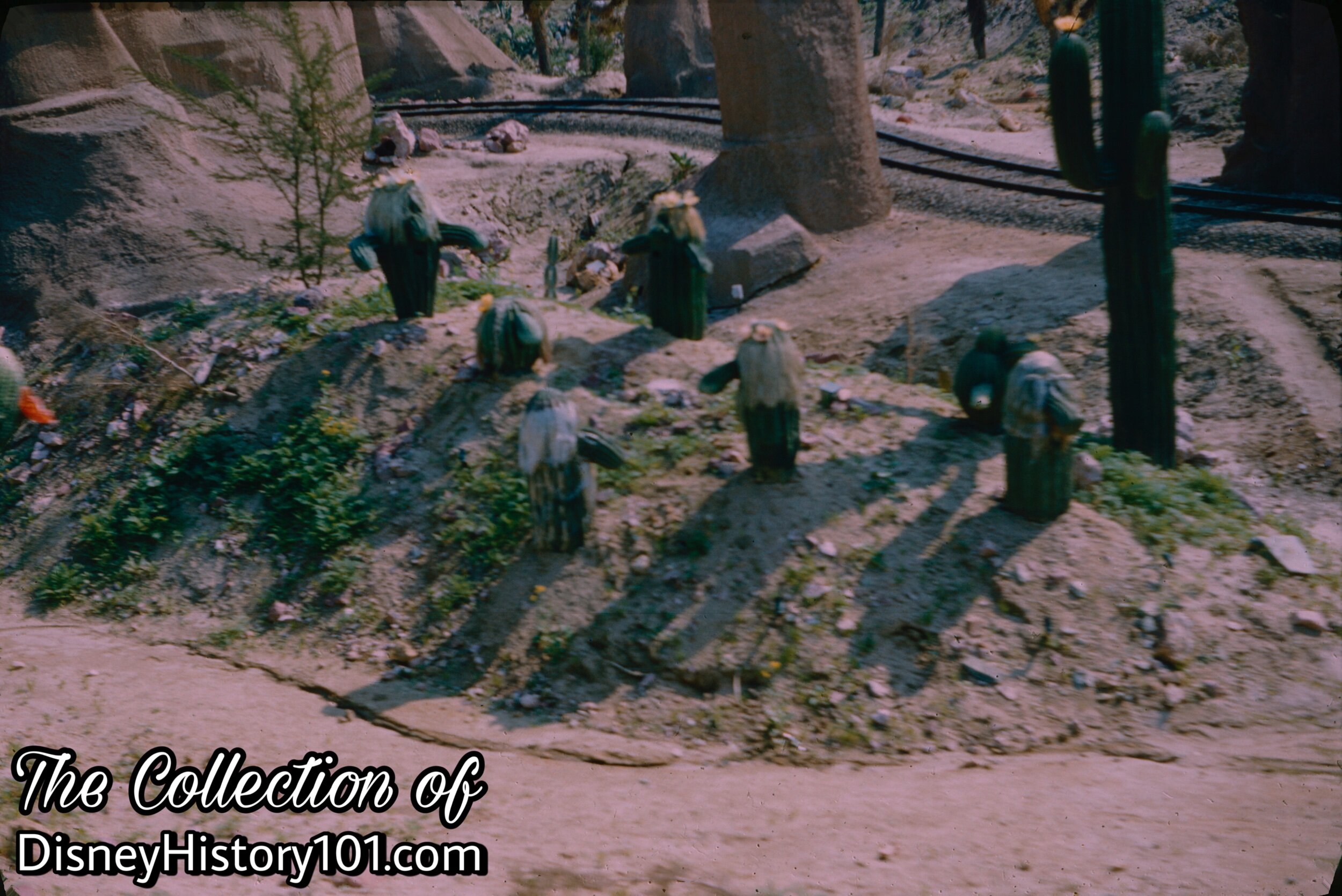
Sometimes the desert heat really gets to our guests…why, somebody even saw the Seven Dwarfs out here yesterday. Sometimes, the desert heat gets to these here cactus, and makes them see strange things - like dark green mine trains heading through the wilderness!
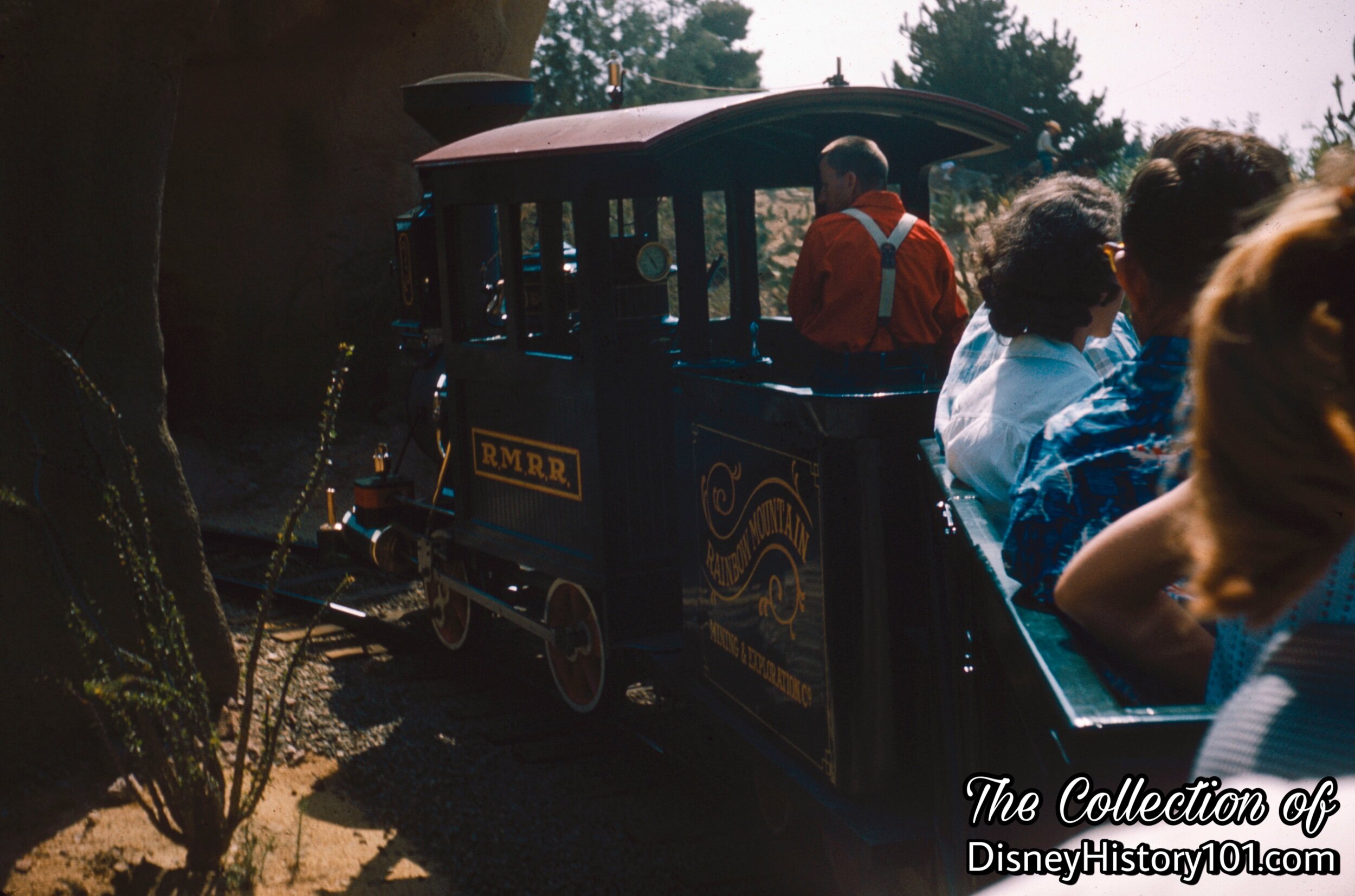
Get ready to head deep into the earth to explore the dazzling Rainbow Caverns! Multiple publications tantalized readers with details of the sights. The complimentary Disneyland News (published for June of 1956) briefly mentioned a multi-colored waterfall, stalactites and stalagmites on all sides, a Bottomless Pit, and a River of Gold. “The First Annual Report To Disneyland Lessees” (prepared 1956, by Disneyland Public Relations Division, Disneyland Inc.) described this portion of the “New Attractions” :
“Then, destination is reached. The train passes though a jagged fissure in the face of Rainbow Mountain itself and is quickly swallowed up in the tomb-like stillness of an abandoned mine. Bones and skeletons glowing in the unnaturally lit interior of the mine give evidence that others have tried this path - - and failed to survive the hazards. The tracks easily span a yawning chasm - - formerly the great barrier to the mine’s interior - - - and the train is now in the Rainbow Caverns. Underground river rush past, showing flecks of pure gold. Mineral formations in the walls give the interior a particular glow, exhibiting all the colors of the rainbow but strangely refracted without natural light. The train rushes on in the half-dark. Many colored waterfalls and cascading streams contribute to the effect of being deep in the heart of the earth. Suddenly, round a bend, a narrow shaft of light appears and the train rushes to meet it, ascending abruptly and once again into the pleasant daylight of Disneyland’s summer. Close by, the Mule Pack Ride, the Stage Coach and the Conestoga wagon rides will be boarding passengers for a more leisurely trip through the desert area.”
All of this dark ride portion of the adventure was housed in the 18,250 square foot Mine Train Building.
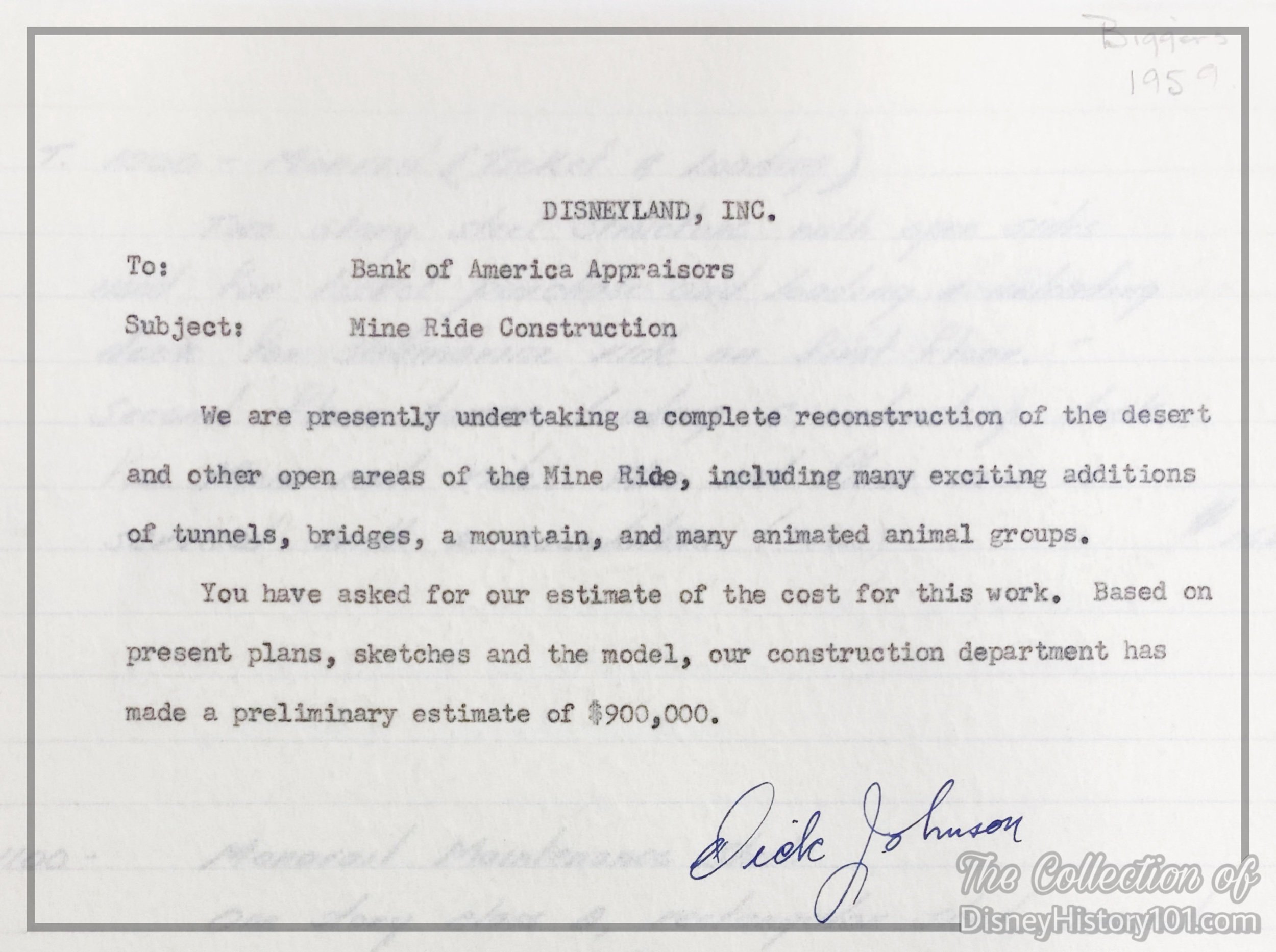
By September 28, 1958, Disneyland, Inc. made approximately $389,181.00 of land improvements to the Rainbow Desert. That same year of 1958, an appraisal of the original ride structure valued it at $275,900 while the original equipment was valued at $91,600.
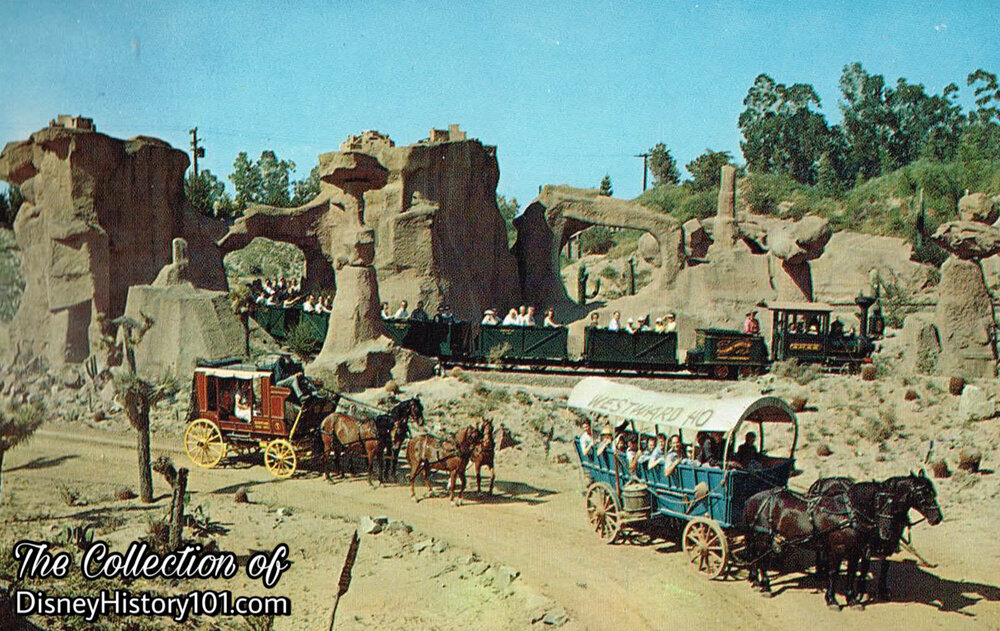
By 1959, Joe Fowler was Vice President of Disneyland Operations Committee and Doc Lemmon of Disneyland Operations was overseeing Operators of Rides & Amusements (like the Midget Autopia), Livestock, Parking Lot, and Ticket Sellers. The Disneyland “C” Coupon of the era once equated the value of a ride aboard the Rainbow Caverns Mine Train with the alternate desert route of the Conestoga Wagons. However, an incident would occur that would result in the end of an era for the “three wonderful ways to enjoy” the Painted Desert!
According to one headline (published just after the incident), “Eleven [were] injured as horses bolted at Disneyland”. The same article continues : “Eleven persons including six children, suffered minor injuries Monday at Disneyland when the four-horse team of a stagecoach bolted. The injured were the driver and 10 of the 12 passengers in the stagecoach at the amusement park. Several were thrown to the ground when the stagecoach collapsed after its undercarriage was torn off by the wild horses. A Disneyland spokesman said the horses became frightened at the sound of the Park’s train whistle.”
A few months later, another syndicated article divulged Walt’s thoughts and feelings over what had occurred. “‘We had stagecoaches riding through the Painted Desert area’, he explained. And we had a few minor accidents on them. Nothing serious, but enough to worry me. We have a fine safety record at the Park, and I wanted to keep it that way. So I redid the desert to do away with the stagecoaches.”
With that, the final horse-drawn vehicle made its way along the dusty trails of Frontierland, on September 13th, 1959.


*Official opening ceremonies took place on June 12th, 1960. Some sources (i.e. “Disneyland Rides & Attractions and Attendance Report” Fiscal Year 1981) cite January 3rd, 1977.
During the 1958-59 winter season, over $6,000,000 of new rides and attractions debuted, including the Matterhorn Bobsled Ride, the Submarine Voyage, the Monorail, and extensive revisions in other rides adjacent to them. The drawing power of those spectacular new features accounted for a larger attendance trend during the summer and winter. So to prepare for the following summer, a major project commenced, re-designing the desert area in Frontierland to provide more exciting and higher capacity rides.
Beginning October 11th, 1959, Mine Train excursions through the Rainbow Mountain Mining & Exploration Co. briefly ceased for refurbishments that were well worth the wait! About this time, Walt Disney was quoted (in Wisdom magazine, published December 1959), “I have great love of animals and laughter.” Given this expression, it wasn't any surprise when (during the following year of 1960), a $1.8 million construction cost far exceeded the preliminary construction estimate of $900,000 given Bank of America appraisers in 1959. This amount brought tunnels, bridges, a mountain, and an unprecedented cast and show to the 7-acre (or, 14 of “nature’s half acres”) parcel of “North American wilderness” in Frontierland!
Joe Fowler (Disneyland Operations Committee) and Earl Vilmer oversaw the Construction & Maintenance division including Engineering, New Construction, Maintenance, and Janitorial related to the installation of the attraction.
Show design was heavily inspired by Walt Disney’s award-winning True-Life Adventures! According to “A University of Disneyland Guide For Nature’s Wonderland Hosts and Hostesses” : “No dress designer can duplicate the wardrobe of nature ; no prop designer or special effects man can do better than a meek imitation of nature’s own trees, rocks…waterfalls. It’s impossible to compete with the Aurora Borealis or a Pacific sunset for a backdrop. But in Nature’s Wonderland in Disneyland, people from around the world can enjoy nature as it is…or as it was…with accuracy and fidelity. To bring the beauty of drama of nature to mankind has been one of Walt Disney’s interests.” This Walt had previously effected through his True-Life Adventures series of theatrical films, where those animals were viewed on a screen.
Many of those films would become most influential to the show design of the Disneyland attraction! There was “In Beaver Valley” which had previously been awarded for Best Two-Reel Short Subject of 1950. On November 10, 1953, Walt released “The Living Desert,” the first film distributed by the new Buena Vista Distribution. The film won an award for Best Documentary Feature, 1953. Later at the 1954 Oscars (a year before the Opening day of Disneyland), Walt Disney & RKO Radio Productions’ “Bear Country” was awarded an Oscar for “Achievement in Two-Reel Short Subject, 1953” at the 26th Academy Awards Ceremony. Upon accepting one of his awards that day, Walt declared, “Well, I just wanna say on behalf of my staff (and especially the naturalist photographers who have played such a great part in making the nature films), ‘Many, many thanks!’” Soon, “the youngster who never saw an elk except in a parade or convention” would soon be “able to see Olympic Elk as he lived his life in Nature’s Wonderland,” at least according to the same aforementioned publication. This “composite True-Life Adventure… based on elements of four Disney Films - Beaver Valley, Bear Country, The Living Desert and The Olympic Elk,” would be the product of a great deal of Walt’s studio staff. [“Walt Disney Disneyland,” page 44, printed by Officine Grafiche Arnoldo Mondadori - Verona; first published 1964]
Walt Disney’s Imagineers knew their audience. About a year after Disneyland began its first day of operation, Herb Ryman continued to produce rough drawings detailing proposed Show additions to the island and shores of Frontierland’s “River Ride.” One particular (c. 1956) rough sketch produced in ink (on exhibit at The Walt Disney Family Museum, Gallery 9) lists natural scenic elements - “Semi-Submerged Logs”, “Dead Trees With Moss”, a “Cave Up High On Bank”, “Rock Strata Ledges”, “Some Cypress Swamp Area,” as well as “Animals” (like “Bear, Buffaloes, Deer, Wild Turkey, Grouse, etc., Goat, Bighorn”). Claude Coats (a WED Project Designer with a talent for color and styling) played a key role in the attraction’s development, according to his “Capsule Biography” prepared for WED Enterprises.
By now, “One of the most popular, and beautiful, attractions in the Park, the Mine Train journey through Nature’s Wonderland,…[was] based on elements of four Disney films, three of them Academy Award winners. In Beaver Valley, Bear Country, The Living Desert, and Olympic Elk, provided the inspiration for the seven-acre adventure,” according to Disney News (published Winter 1967-1968). Recreating something “natural” requires work similar to that of a movie studio. “A University of Disneyland Guide For Nature’s Wonderland Hosts and Hostesses” continues : “To recreate Nature’s Wonderland required the skills of the photographer, the naturalist, the artist, the landscape designer, the mechanic, the plumber, and many others.”
RockWork and hardscape was designed with much tooth (texture and rough surface). Then areas were landscaped.
“The Flora of Nature’s Wonderland”
For instance, a total of 156 species of plants, trees, and flora were imported into Nature’s Wonderland and placed by landscape architects Evans and Reeves, to generate authentic settings. Among these were palo verde trees, mesquite, joshua trees, and cactus. According to Vacationland magazine (published Summer, 1960), the result was a Western Mine Train that would take guests through “a faithful recreation of the forest regions of Wyoming, the deserts of Arizona and New Mexico, mountain terrain of Colorado and many other sections of western wilderness…”
One arid rock canyon in Nature's Wonderland averaged 110 degrees of heat with virtually no water. It was the perfect home for California juniper, Joshua tree, piñon pine and red-flowering ocotillo.
In addition, Walt had the telephones along the backdrop of Frontierland removed, paying the utility company to place the telephone poles underground.
This attraction would be (according to the very same c.1960 Vacationland), “populated by the natural inhabitants : an assortment of 50 separate varieties of bird, beast, and reptile, representing every specie of animal still roaming the North American continent.” The larger (and more varied) animal cast of 204 life-like animals (according to “The Disneyland Diary”), were first envisioned by character animator Marc Davis and then translated and developed into three dimensions by artist Bob Mattey (who helped build the terrifying “40-ton” squid which James Mason battled in “20,000 Leagues Under The Sea”), who would now help bring these animals to life using similar methods (and new ones).
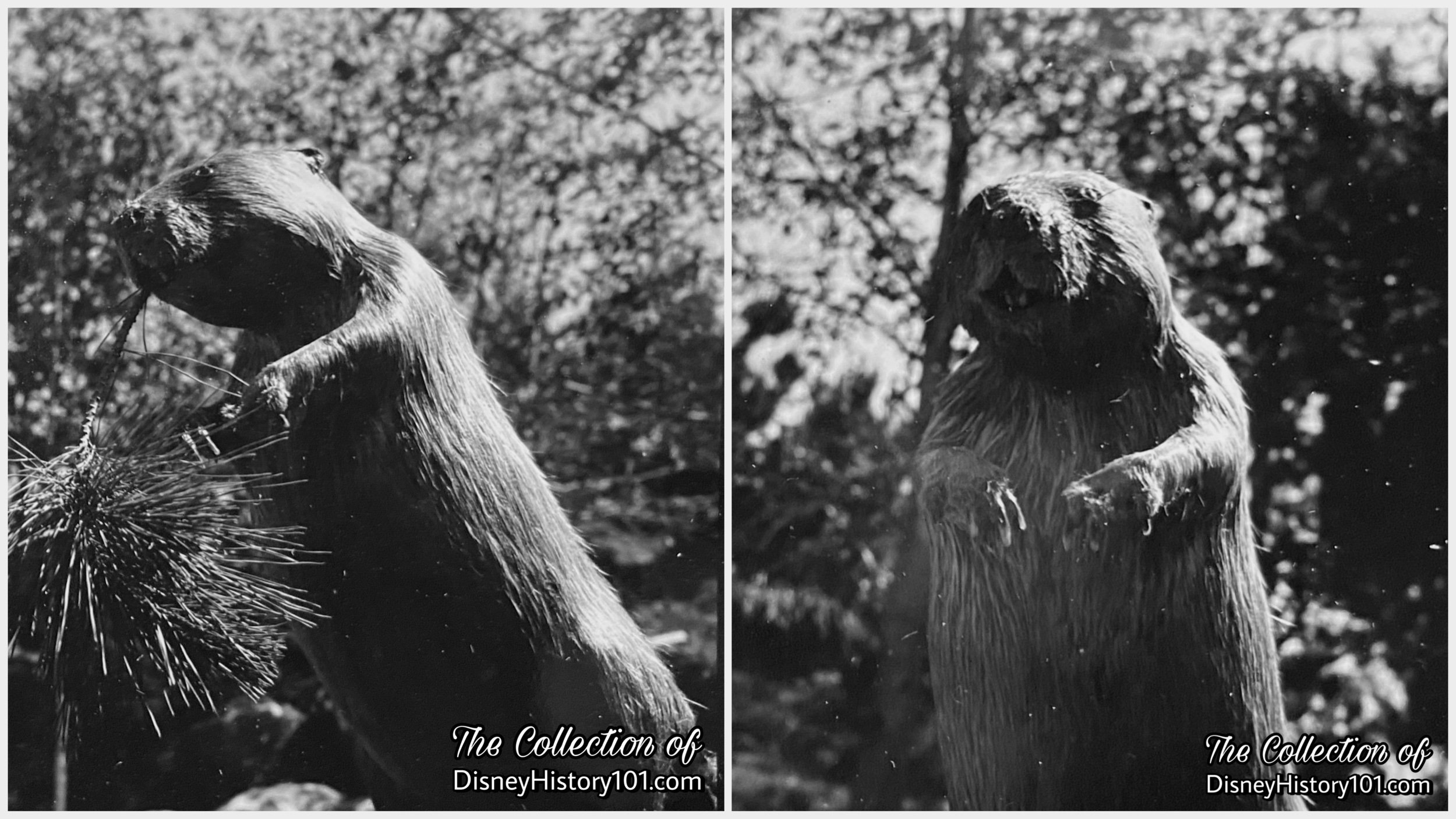
“Audio-Animatronics”
Developed by WED Enterprises, this amazing system utilizes pneumatics hydraulics and electronics to animate human, animal, and other three-dimenstonal figures. Many Disneyland attractions feature Audio-Animatronics figures. “The term ‘Audio-Animatronics’ was first used to describe the bears and beavers in Nature's Wonderland.”
To accomplish this show, the attraction would employ Audio-Animatronics® - the Disney-designed system that combines sound, mechanics and electronics for three-dimensional animation. The (more than two hundred) “mechanical marvels” included representatives of : Coyote, Beavers (pictured above), Frogs, Ravens, Raccoon, Prairie Dogs, Blue Jays, Black Bears, Rainbow Trout, Side Winders, Meadowlark, American Eagles, Bobcats, Owl, Burrowing Owls, Hawk, Elk, Jack Rabbit, Antelope, Gila monster, Swallows, Robins, Road Runners, Lizard, Grazing Elk, Woodpeckers, Wild Pigs, Mountain Lions, Wild Turkey, Badgers, Skunk, Fox, Quail, Ferret, Armadillo, Rattlesnakes, and Desert Tortoise. By this time, WED Enterprises, Inc. (which later created designs and held patents for Audio-Animatronics) had come a long way in making their animals move. These animated figures were not as the sophisticated Tiki Room Birds, pirates and presidents that followed, but they did have varying degrees of animation - “one or two movements to many complex body actions.” Most of this movement was accomplished through “electronic hydraulic-pneumatic” technology combined with the early “cam-lever” technology. There were hidden well - “skins” or the ground hiding metal bases. There were cement rocks (which animals were bolted to), hiding the mechanisms and self-contained hydraulics systems. Fiber-glas rocks and trunks (with doors) housed animation electronics. Other animals in the water (as fish and bears), had timer controls and proximity switches to trigger their “swimming” animations.
According to Bob Thomas (of Associated Press), “all of these [were]… formed in plastic, stuffed with mechanical innards, covered with real skins treated for weathering.” Unlike true-life animals, many of these animated characters (i.e. the Bears, Battling Elk, Prong Horn Antelope, the Mountain Lion, and even the Balancing Rocks) now “ran on timers,” typically following the script, and acting on cue when all went well. These actors were costly - for instance the Bears alone cost $64,733, the total cost of all Sheep was $29,449, all the Gray Foxes cost $2,933, and the Raccoons cost $3,294 (to highlight the value of a few). As a sidelight, part of this expense included the high cost of natural skin coverings, (which were swiftly changed to synthetic skins around 1962).
By April of 1960, the total cost of the Show had reached $1,800,000. By June of 1963, the cost of the props, dressings, and “actors” involved in this particular enormous Disneyland show was divulged in one publication, at a total of $2,581,000 - surpassing “the original combined cost of the Statue of Liberty, Grant’s Tomb, and the original production of Ben Hur”. Due to the large audience at Disneyland, many of these were conveniently inspected by Walt Disney at his Walt Disney Studio in Burbank. You may recall seeing images of Walt and Bob Sewell inspecting Mountain Lions, or Walt and Wathel Rogers inspecting scaled-down models of animated elk during this time.
The DISNEYLAND ENGINEERING DEPARTMENT was the coordinating group working between the world's most unusual creative organization - WED - and the world's most unique maintenance organization. Disneyland engineers work closely with maintenance artisans and WED personnel, who are responsible for the show at Disneyland. A conventional routine directed engineer may become involved in a bear who isn't properly scratching his back or some other critter. The Disneyland welding department staff was capable of working on all types of metal and using all types of welding techniques. They had to be flexible, fast, and ingenious, with a specific skill in performing ten rush jobs at one time. The staff performed their surgical work on crabs, elephants, hippos, battling elks, drunken pirates, and dancing dolls in Small World.
Bud Washo remembered how Walt would even act out animation. “I remember working on the Painted Desert and we were talking about the bobcat on top of the big cactus. He would stand up there and lift his hands up like paws, and he said...I want it to go ARRGGG!..like that.”
“Disney's technicians have done well --- too well, in fact. The birds in Nature's Wonderland are so realistic that blackbirds (real ones) have been attacking ravens (animated variety) perched in the trees of Nature's Wonderland. Owls (Disney created) are being pecked into the repair shops by frustrated crows and blackbirds (live ones). And to top it off, a nest of baby red-tail hawks --- the realistic but unreal kind - so confused a mother bird flying overhead that she tried to deposit her own children's dinner down the throats of the young hawks! Wathel Rogers, a Disneyland animator, just shakes his head in puzzlement. ‘These migrating birds flying through Nature's Wonderland are a sight,’ he says, ‘They swoop down like dive bombers on the attack, sink their beaks into a raven's wing and take off as though someone had fed them a loaded worm. Then, from a tree nearby, they stare at the raven and try to figure out why he doesn't fight back!‘ The casualty report includes three ravens in Disneyland repair docks for shattered wings, an owl with a busted beak, and feathers all over the place. Live bird injuries have been restricted to wounded pride and broken spirits. Bill Martin, project director, indicates how complicated this situation may become. ‘The other day a bird landed on my head out here. When I brushed him off, he flapped away as though he had just seen a ghost move. I guess he thought I was animated too!!’”
Those “brass-trimmed” locomotives (“patterned after the gold and silver ore carriers of a century ago) also received a rehabilitation and a new coat of paint (or two).
The result was an “all-new” exactly nine-minute (no more, no less), 2,307-foot Mine Train Thru Nature’s Wonderland route through “faithful recreations of the forest regions of Wyoming, the deserts of Arizona, and New Mexico, mountain terrain of Colorado and many other sections of western wilderness….These are dominated by Disneyland’s second great mountain, ‘Cascade Peak’, visible from almost all Frontierland and easily recognized by its giant waterfalls that plummet from rocky ledges high on its granite slopes”, according to Art Linkletter’s own description. In addition, the little mining town of Rainbow Ridge also experienced a “boom” of expansion and development as far as the highest ridge! The “D” (and ultimately “E” ticket attraction) featured multiple dramatic animatronic vignettes of “life and landscape” recreated from five of Walt Disney’s greatest True-Life Adventure movies (four of these Academy Award-winning) - Beaver Valley, The Olympic Elk, Bear Country, The Living Desert, and The Vanishing Prairie. The new attraction (which contributed toward carrying the total Park investment to $34,500,000) was both exciting and educational! Even more, it was Walt’s intention that those reflecting on “the animal world” would acquire “a renewed sense of kinship with the earth and all its inhabitants.”
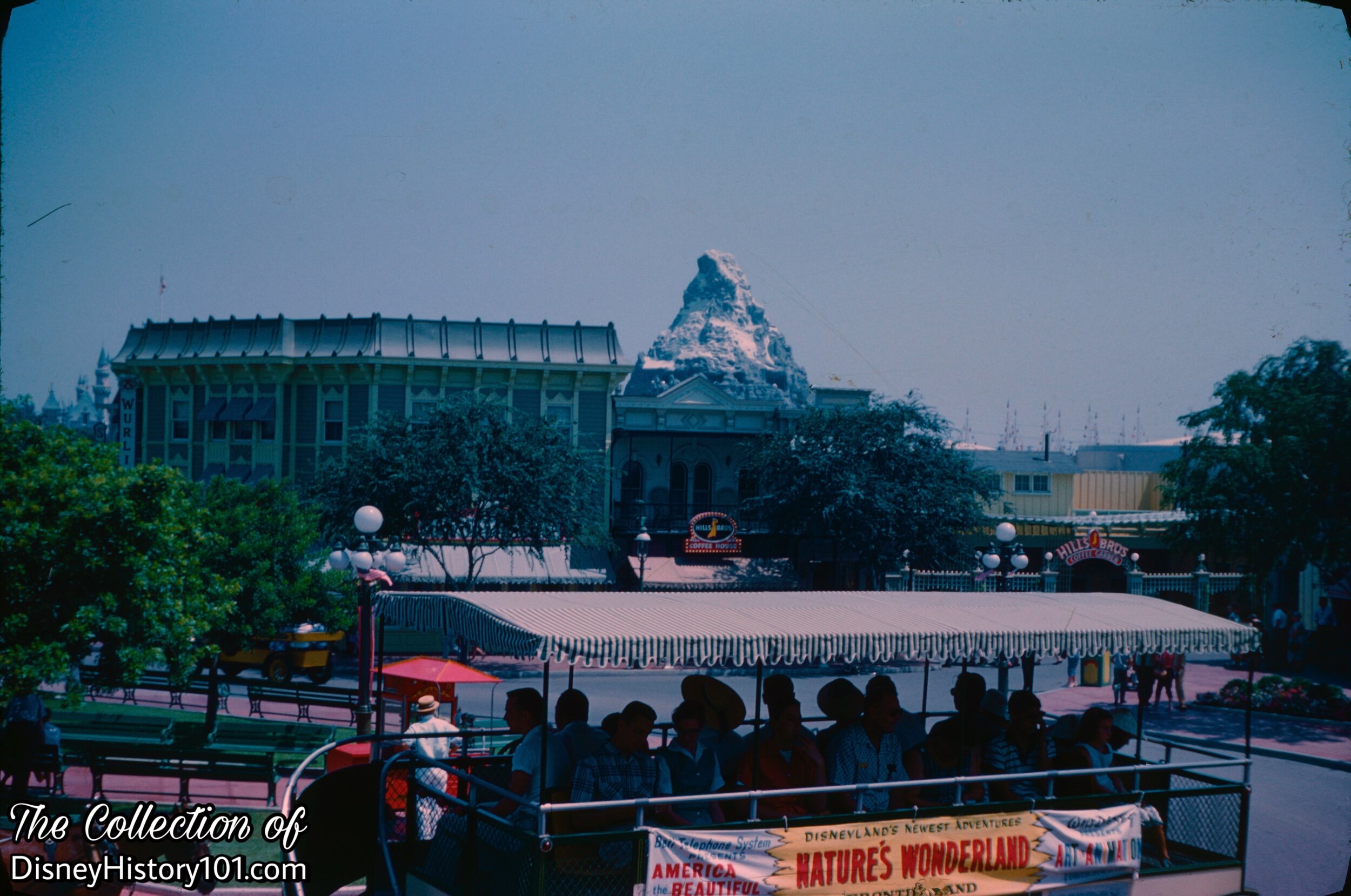
The Main Street Omnibus heralded the newest attraction of 1960 - the old-west adventure of the Mine Train Through Nature’s Wonderland!
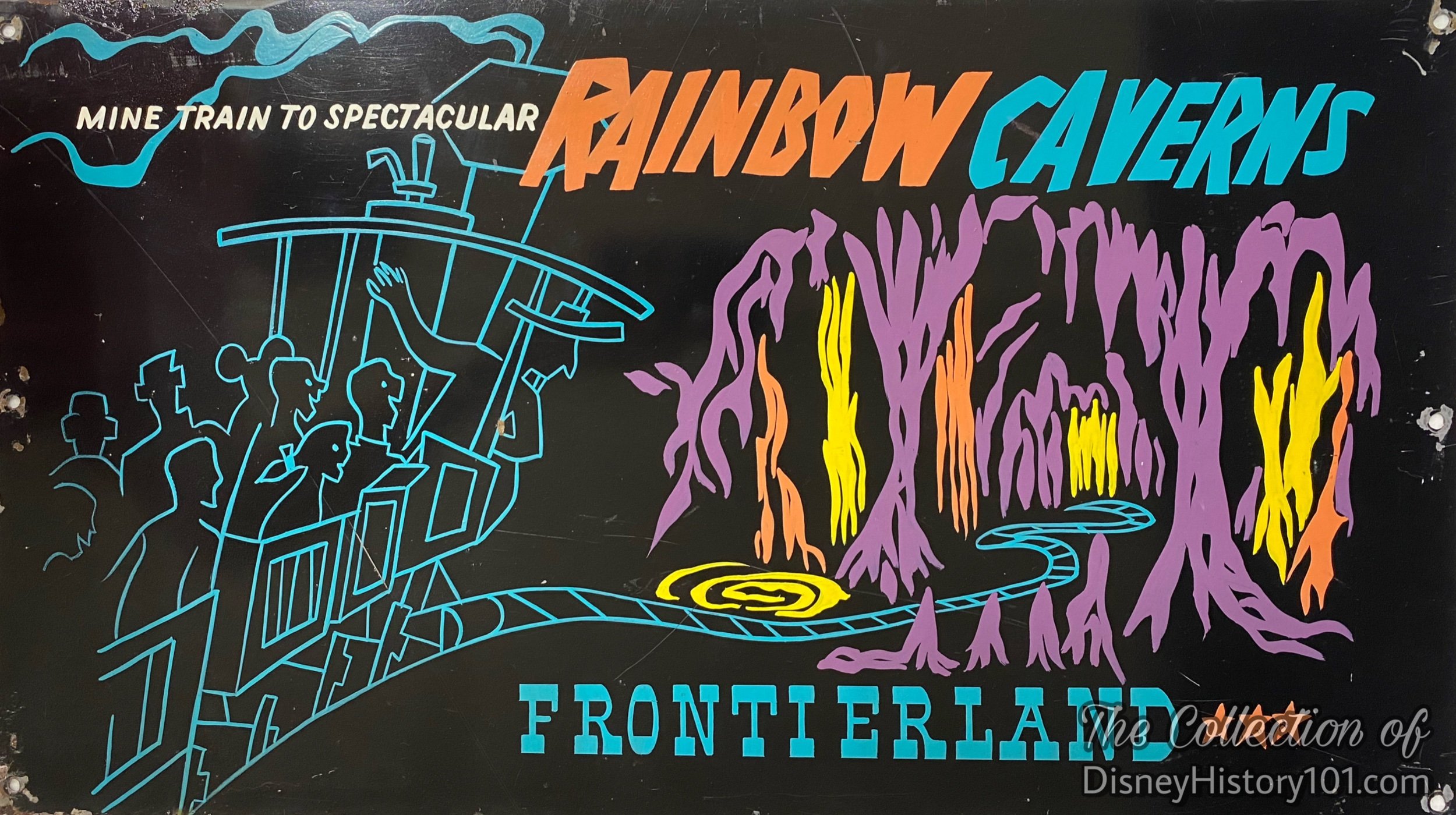
By 1960, the Guided Tour of Disneyland included a fascinating trip, via mine train, through Disneyland's newest adventure, Nature’s Wonderland.
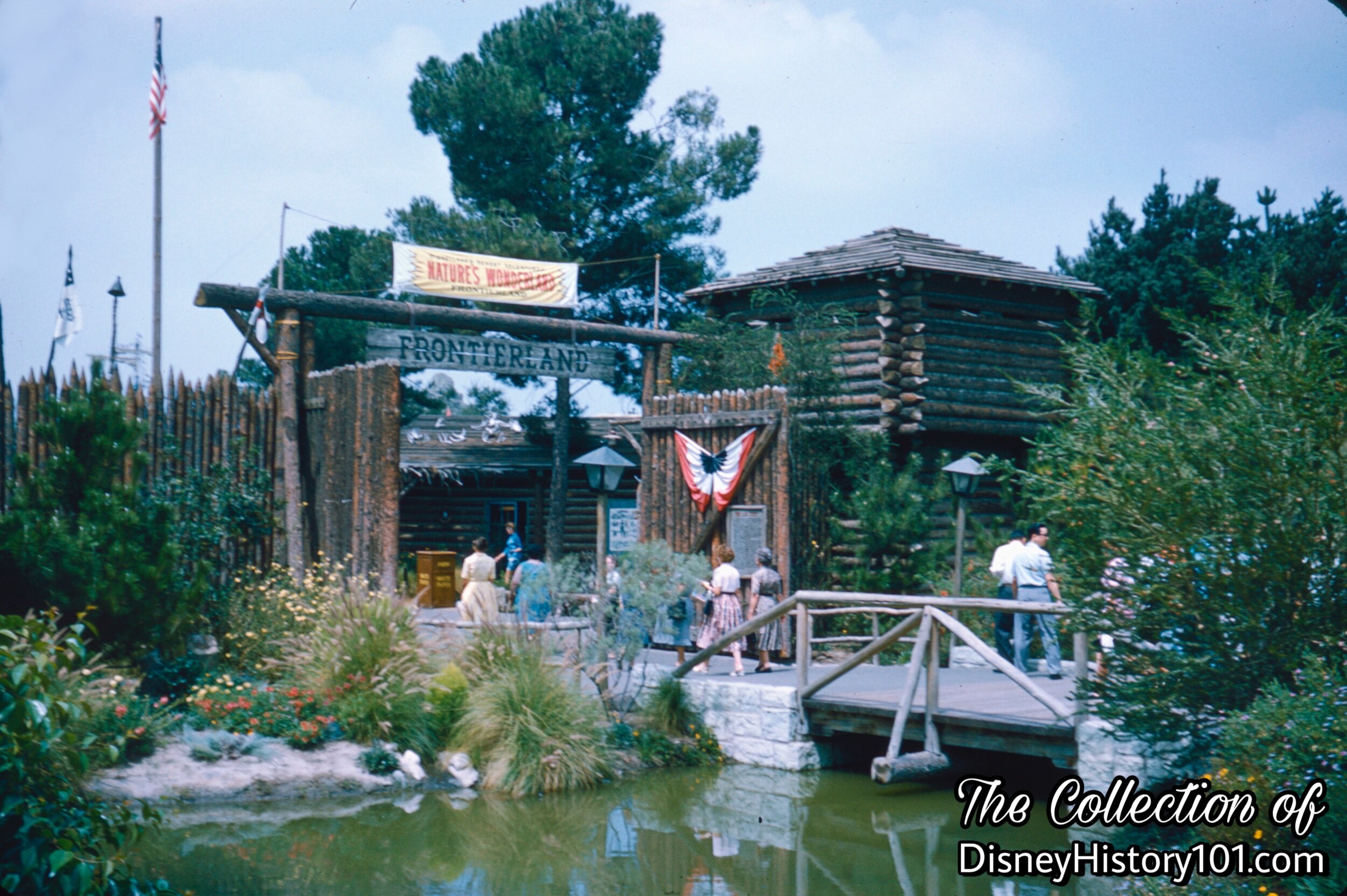
The Mine Train Thru Nature’s Wonderland received much fanfare when it opened. The Frontierland Stockade celebrated Frontierland’s newest attraction with banners and bunting! All art work, posters, etc. were created by the Walt Disney Studios.
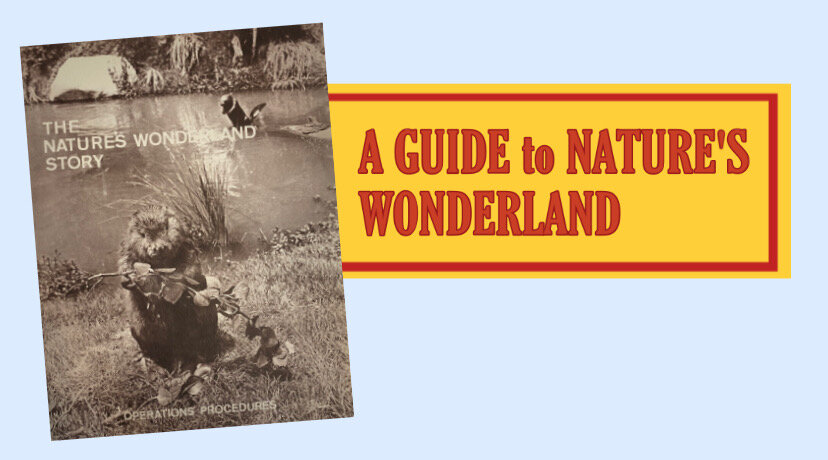
This Operating Guide/OG (approved by Dick Nunis), was created for the Ticket Sales Hostesses, Attraction Hosts and Operators, Engine Operators, Station Hosts, and Backstage Cast (of mechanics, electricians, craftsmen and others) of the Mine Train Thru Nature’s Wonderland! At seven acres and 2,307 lineal feet of track, this was Disneyland’s largest show at the time. To quote from the guide : “Now, it requires the many skills of the ‘backstage’ crew who maintain this attraction, and the ‘story telling’ skills of the ‘on stage’ crew to put on a ‘good show’.” From time to time, we’ll refer to this guide and “outline…the specific procedures for this attraction….to tell a good story.” We’re told, “your guests will appreciate it”.
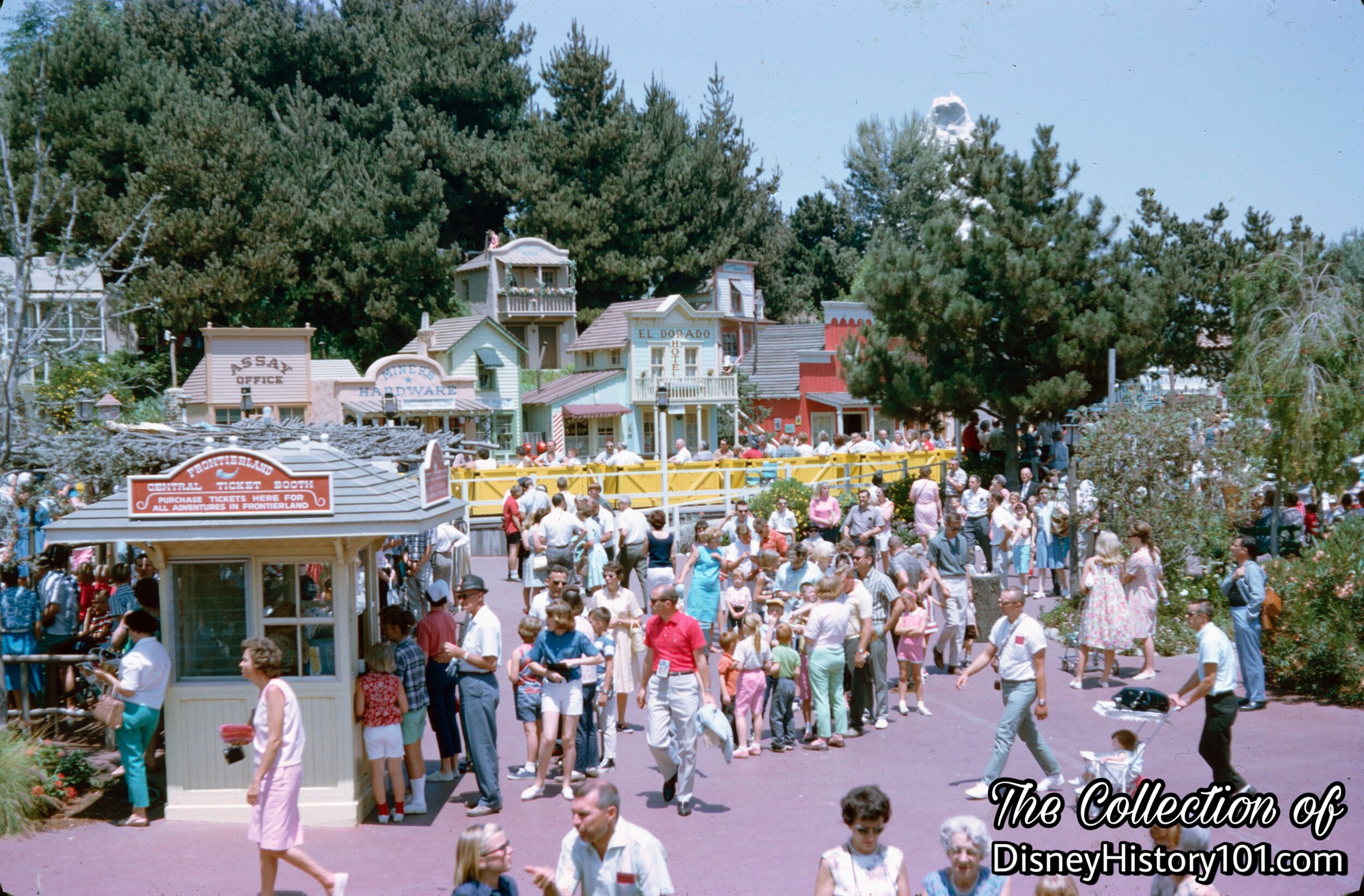
Those trees behind the frontier town of Rainbow Ridge obscure the turn-of-the-century Main Street U.S.A. and Matterhorn mountain from guests. Note the Matterhorn in the following photo.
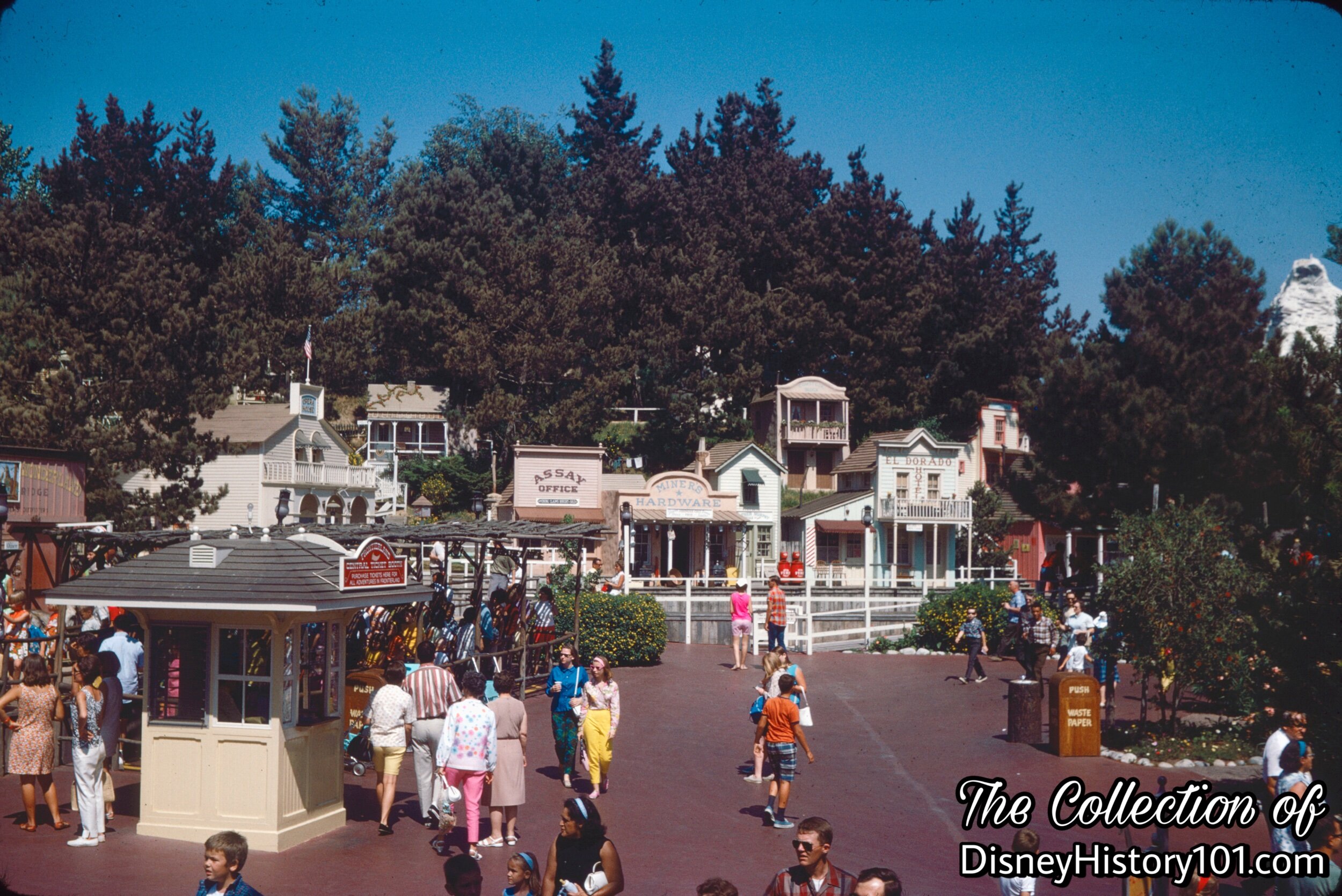
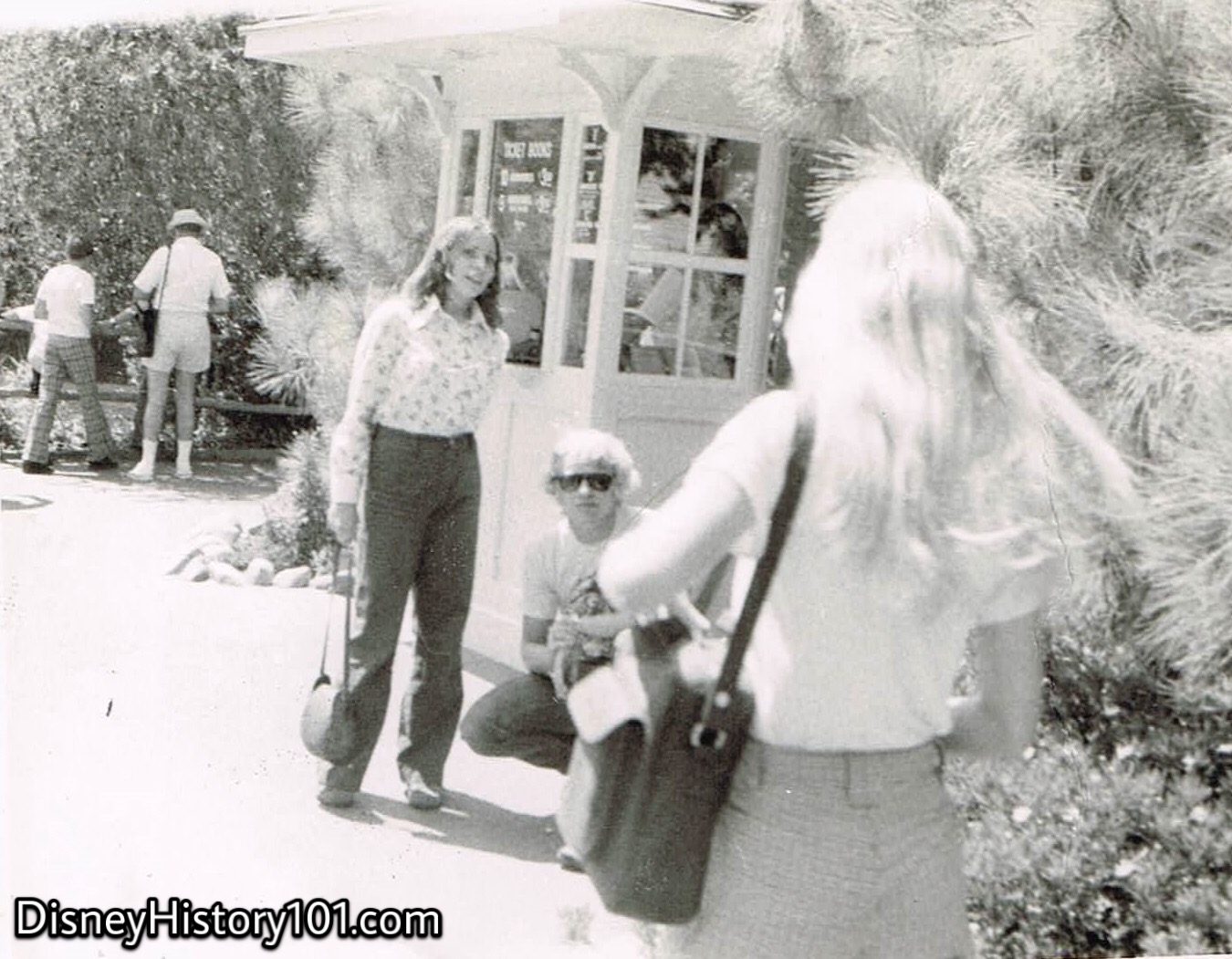
There were three ticket booths - FRONTIERLAND CENTRAL TICKET BOOTH #1 (FRITO AREA), FRONTIERLAND CENTRAL TICKET BOOTH #2 (BURRO AREA), and FRONTIERLAND CENTRAL TICKET BOOTH #3 (PLANTATION AREA). According to manuals (published, 1964), Ticket Sales Hostesses were (invariably) girls. These provided information for both the Mine Train Thru Nature’s Wonderland and the Mule Packs.
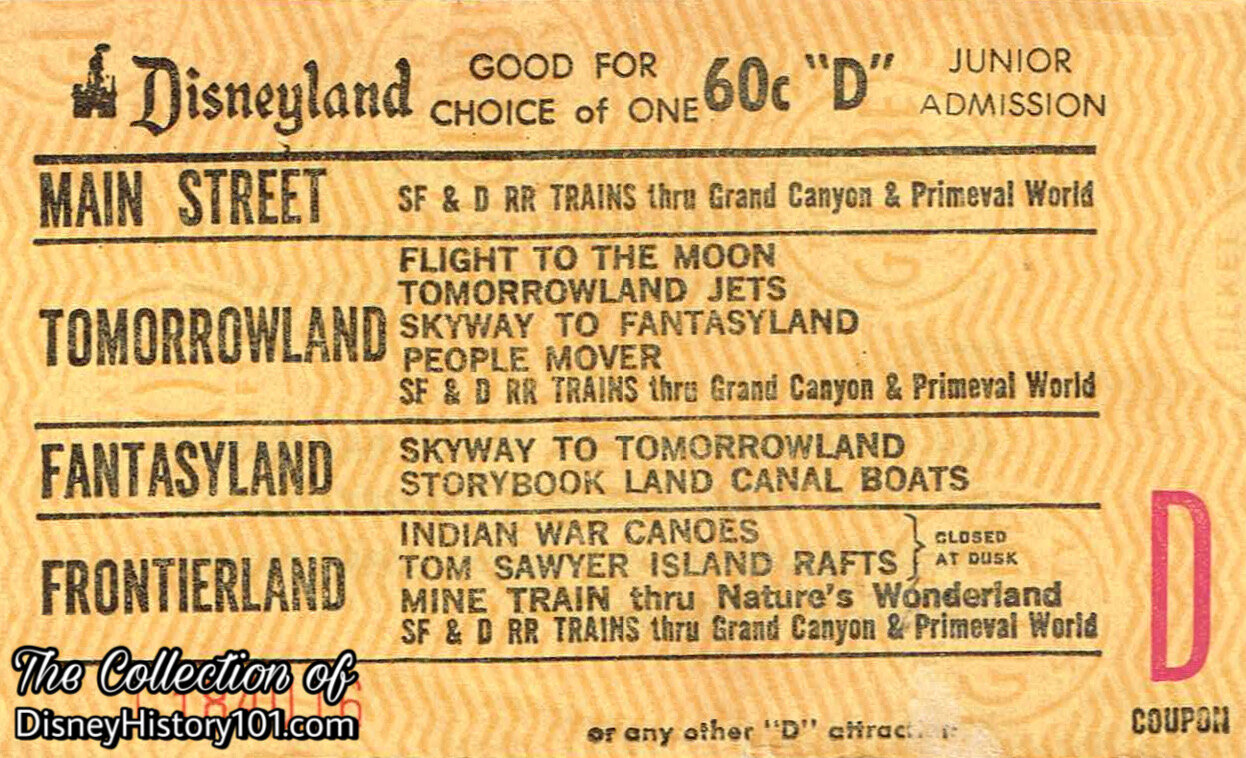
In 1958, admission for passage aboard the Rainbow Caverns Mine Train was one “D” coupon, or 35 cents. In 1965, the cast of admission for a ride aboard the western mine train through Nature’s Wonderland, Rainbow Caverns, and much more, was exactly one “D” coupon, or 60¢.
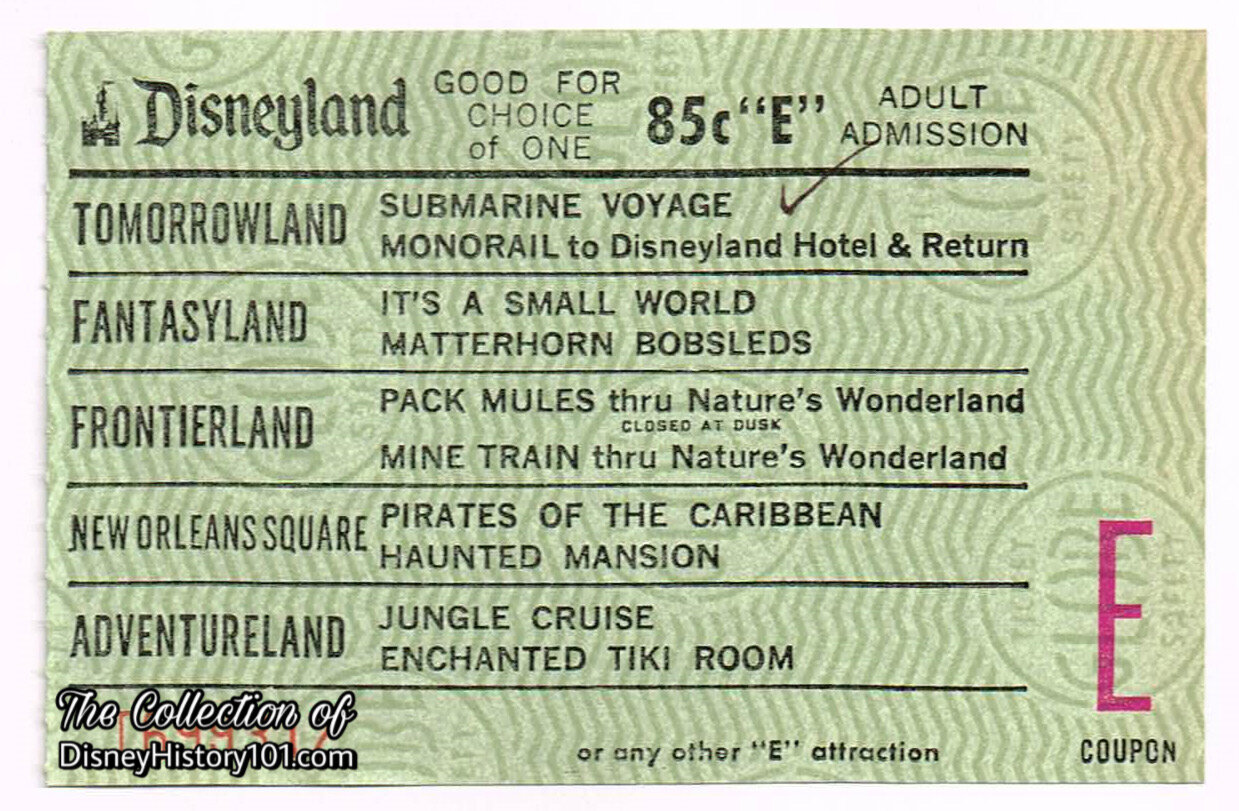
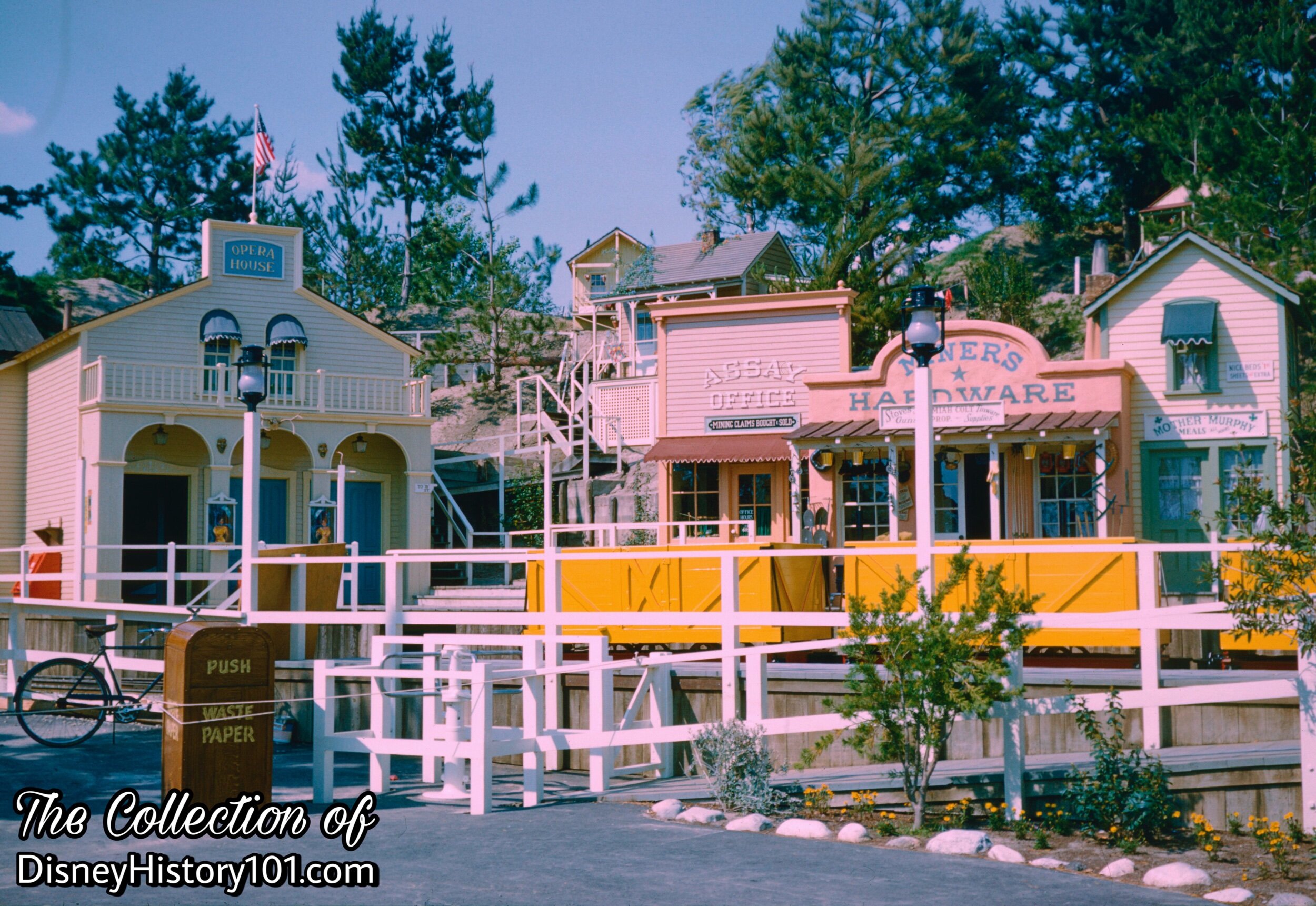
Welcome to the “little” mining town of Rainbow Ridge! If’n ya want ta see just how small it is, just make yer way towards those buildings up in the hills. Walt Disney’s Imagineers employed “forced perspective” and landscaping techniques to give the town depth! Art Director Bill Martin generated many conceptual drawings of Rainbow Ridge.
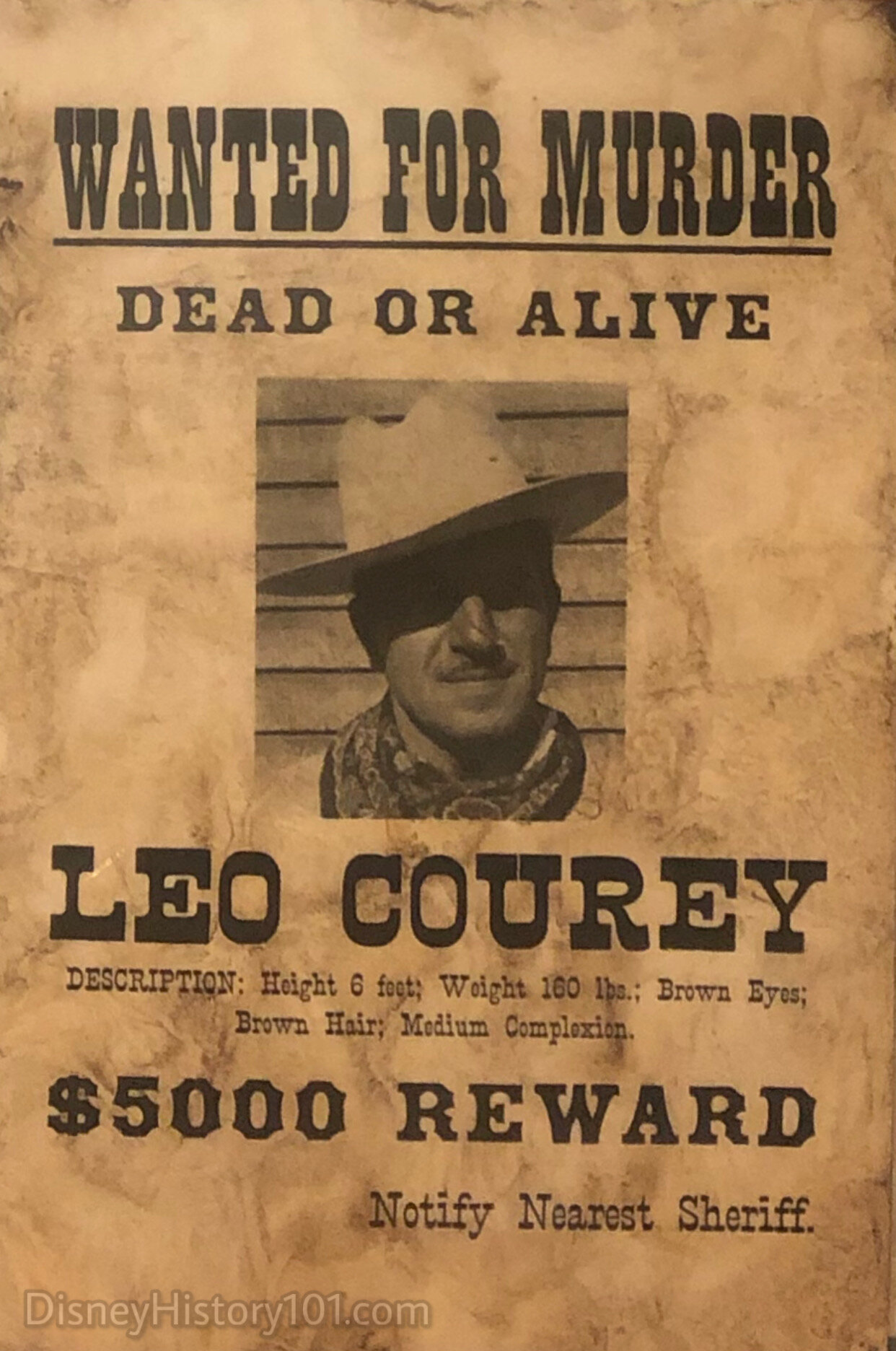
“Audience Waiting Areas” are especially designed as part of the attraction to make the guest's time waiting in line as comfortable as possible. Before we head out into the Painted Desert, we pause to look at a few Wanted Posters (perhaps hung by resident U.S. Marshall Willard P. Bounds). Be on the lookout for more of these scoundrels around the town of Rainbow Ridge. Why, only a few moments ago, the local sheriff engaged in a stand off with the villainous Black Bart after he robbed the Golden Horseshoe’s receipts and took off on foot near the outskirts of Rainbow Ridge! Of course, real vintage wanted posters didn’t have photographs on them as this would have been problematic considering the printing process of the era.
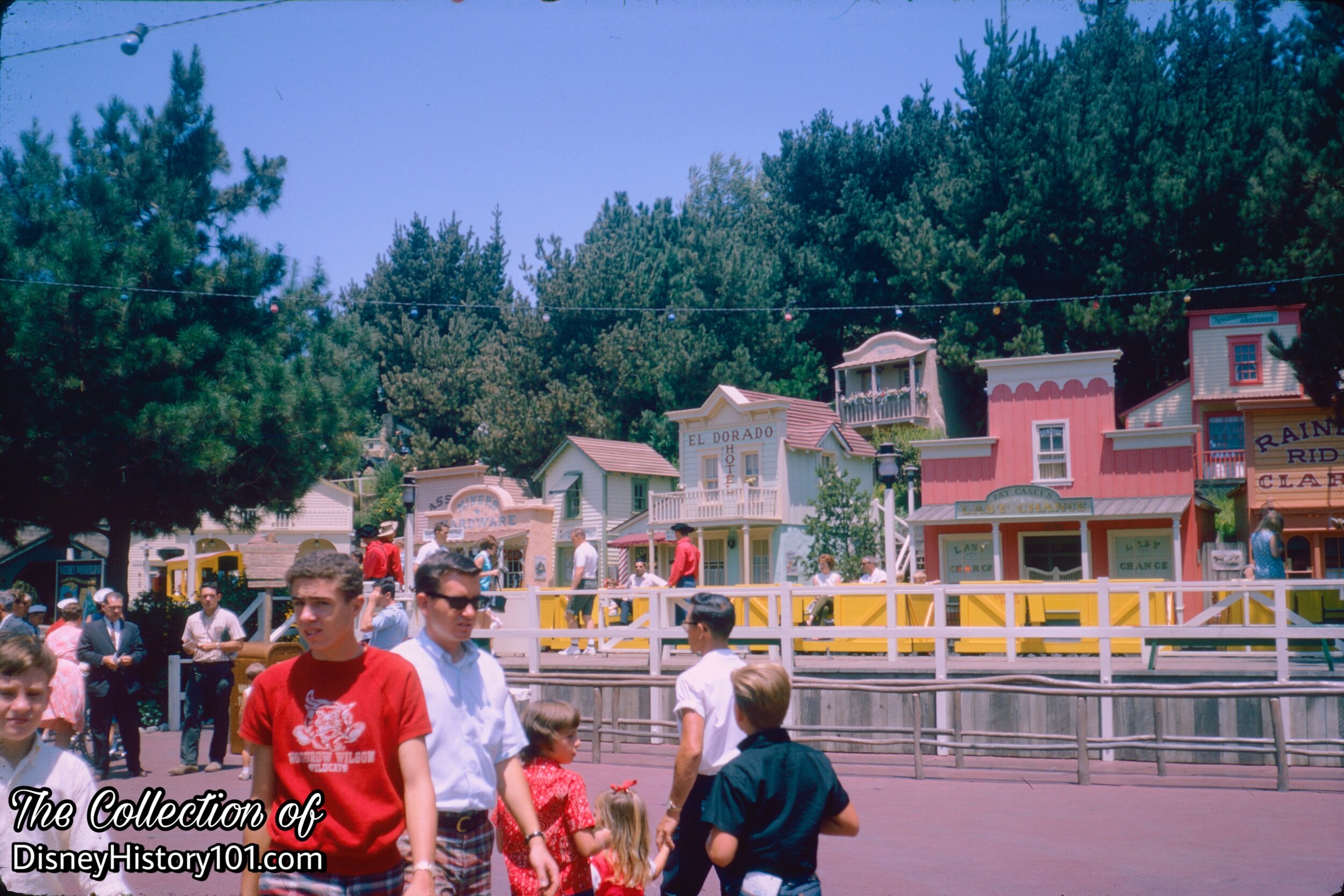
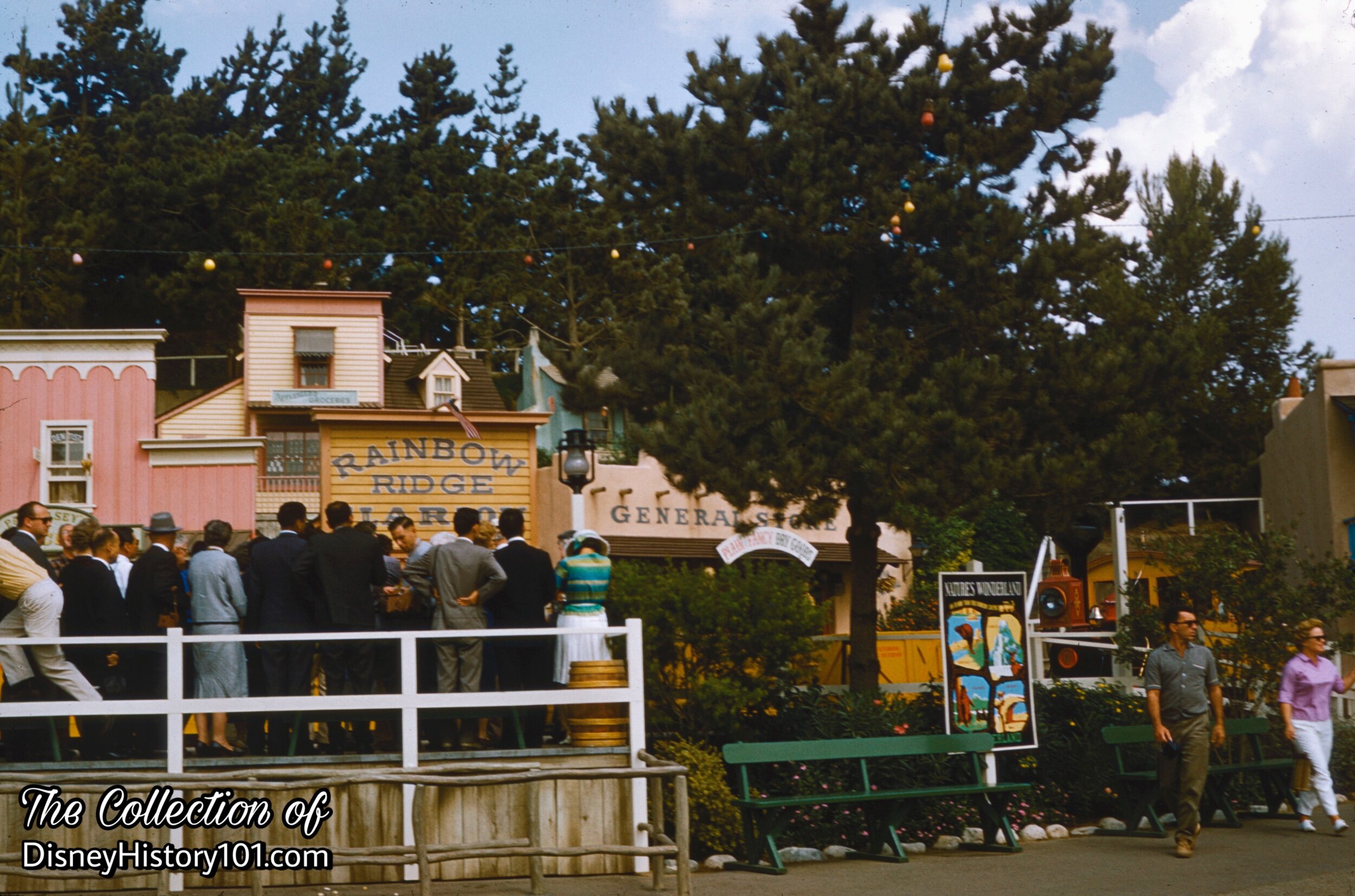
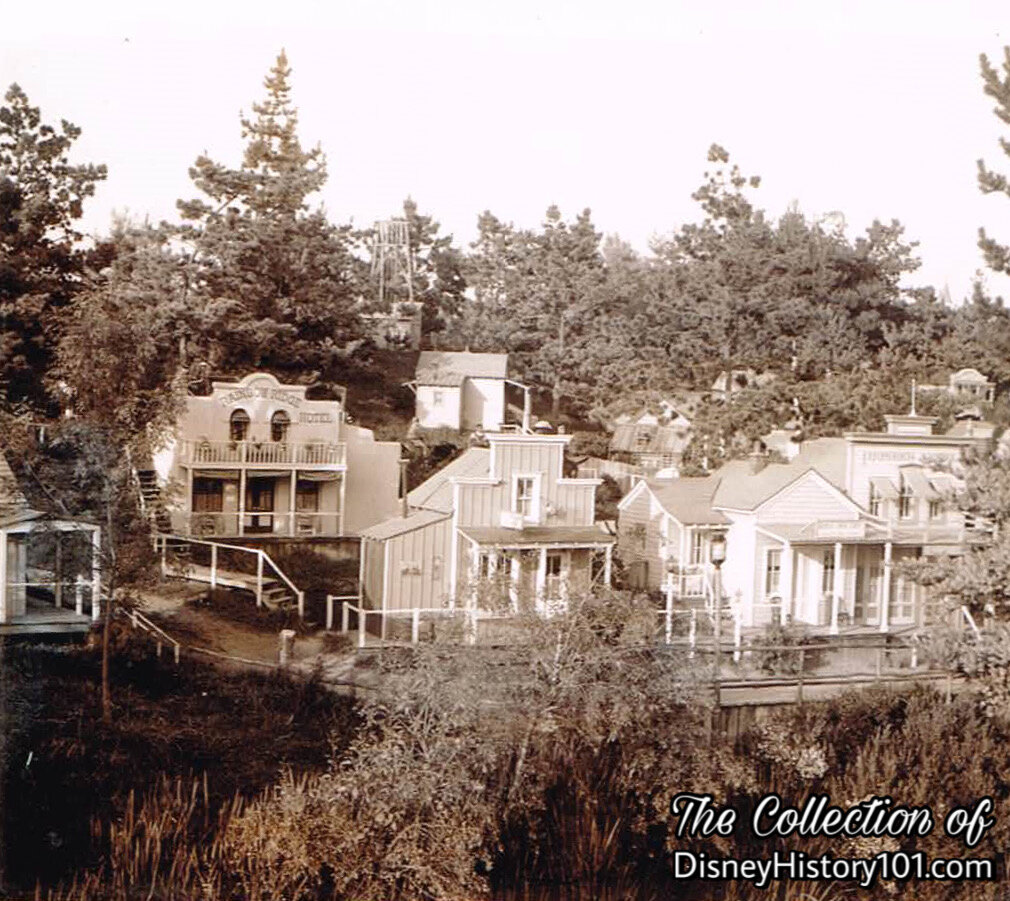
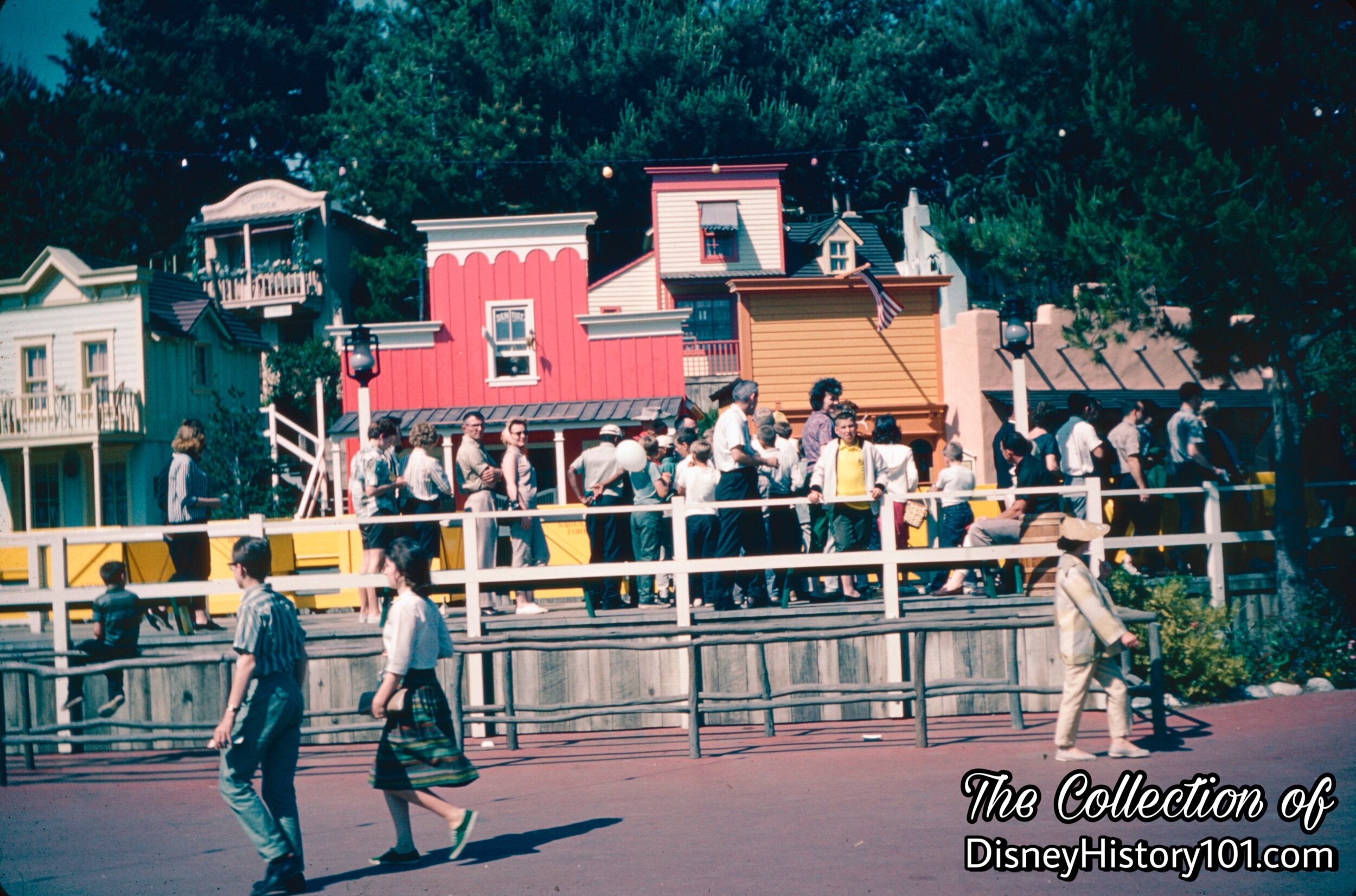
You’ll notice that nothing stops these little mine trains from running (not even a little minor refurbishment to the structures of Rainbow Ridge)!
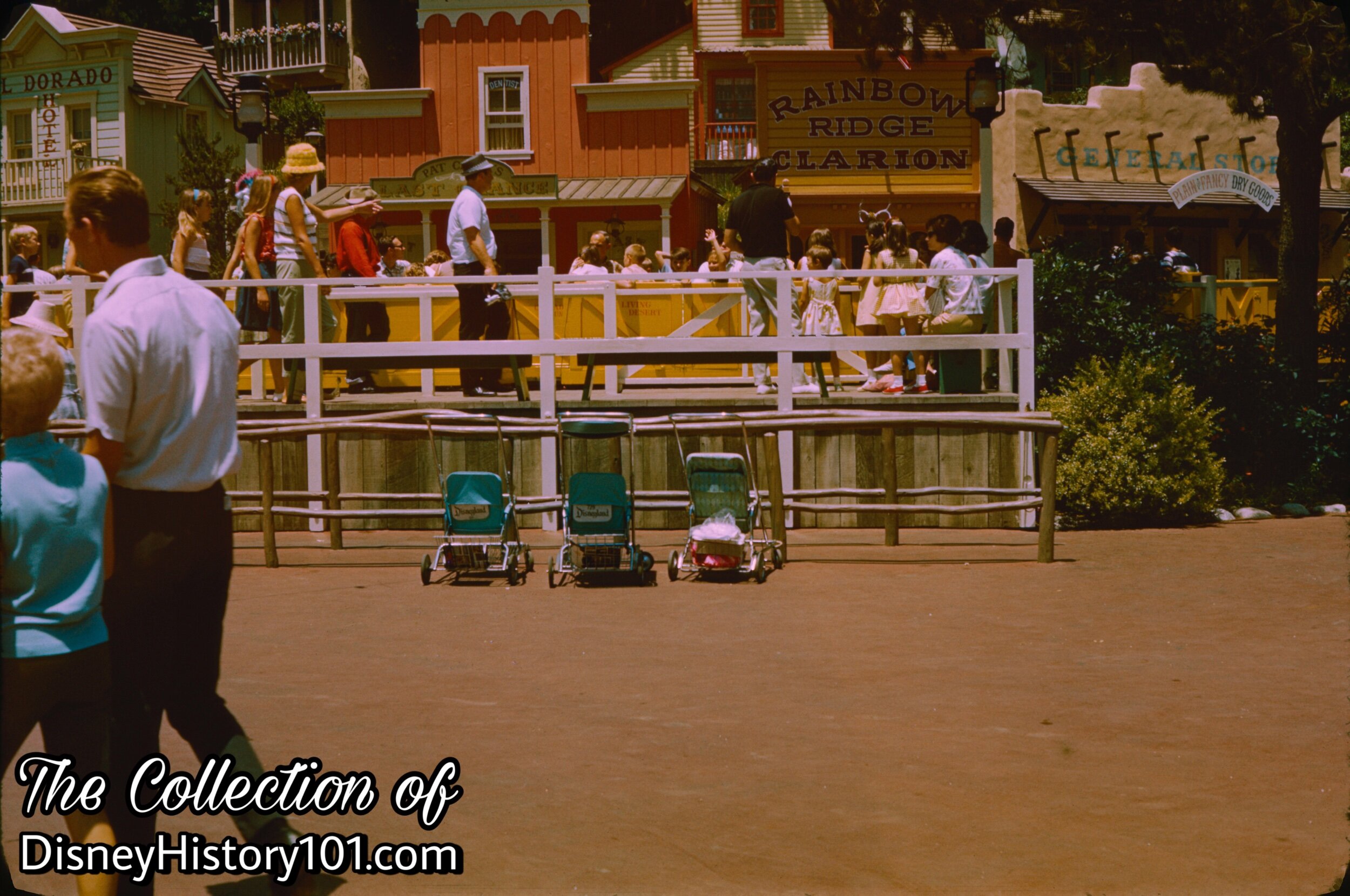
This is the last chance to stock up on supplies before heading out into the rugged wilderness.
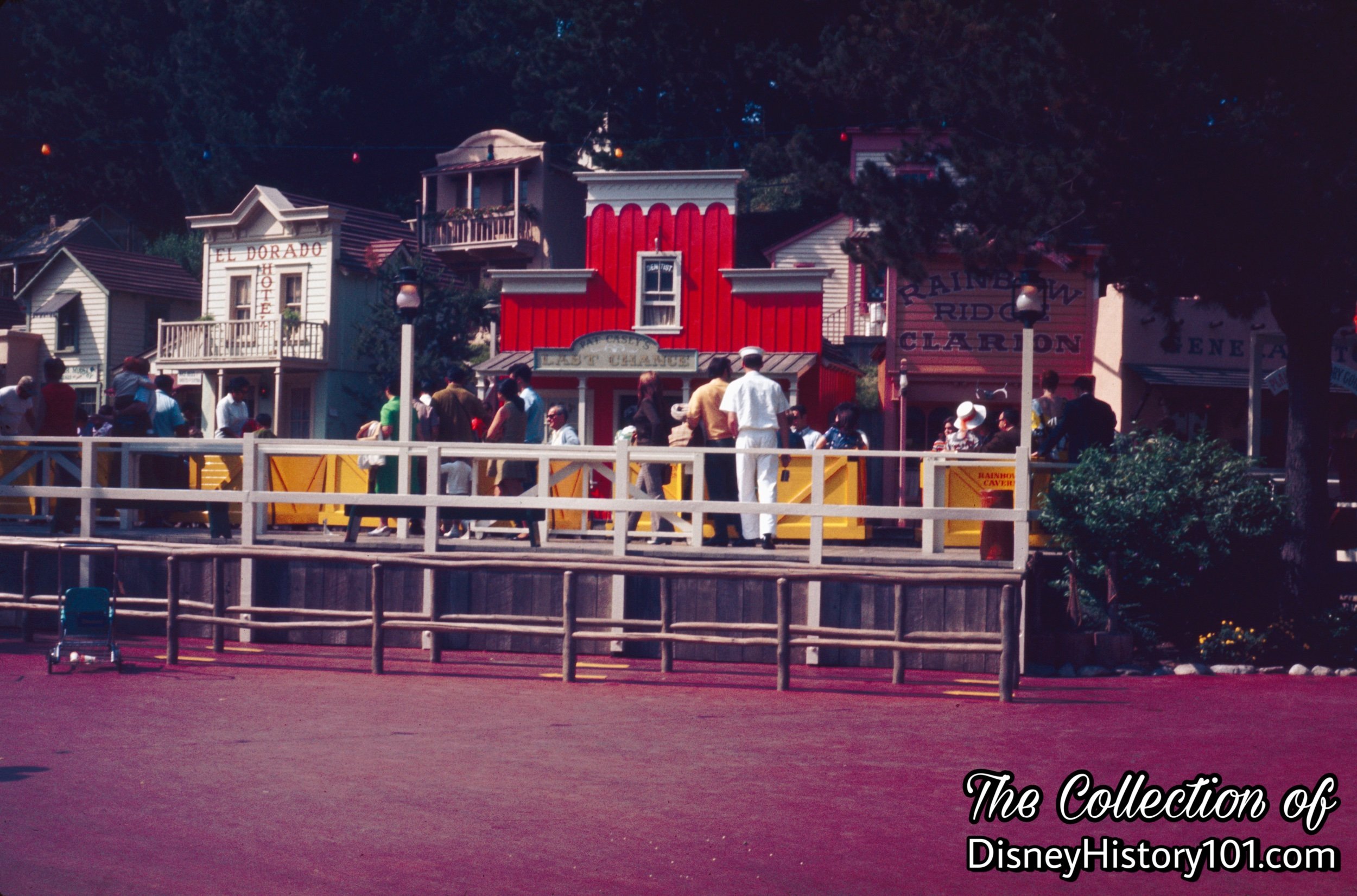
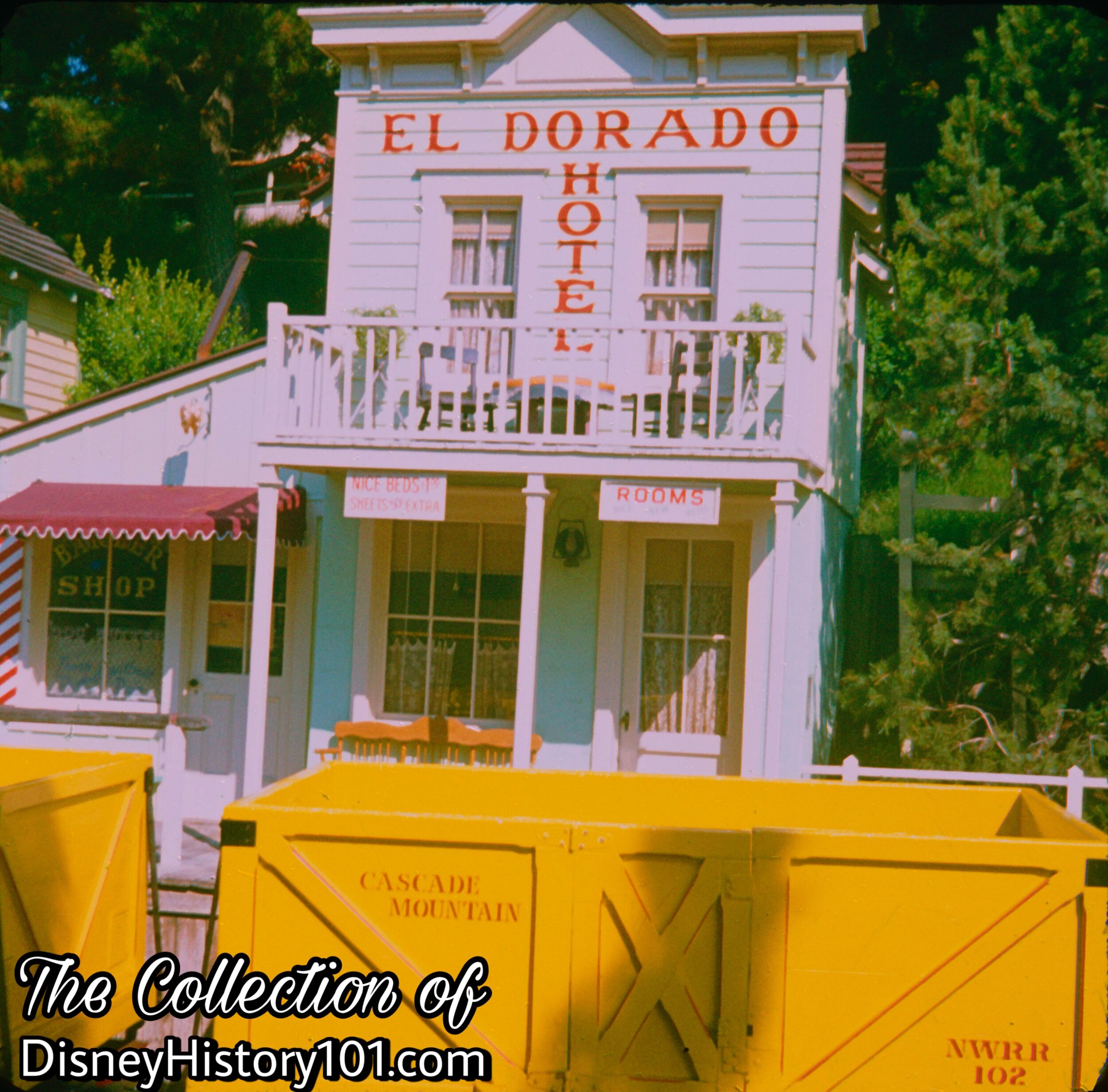
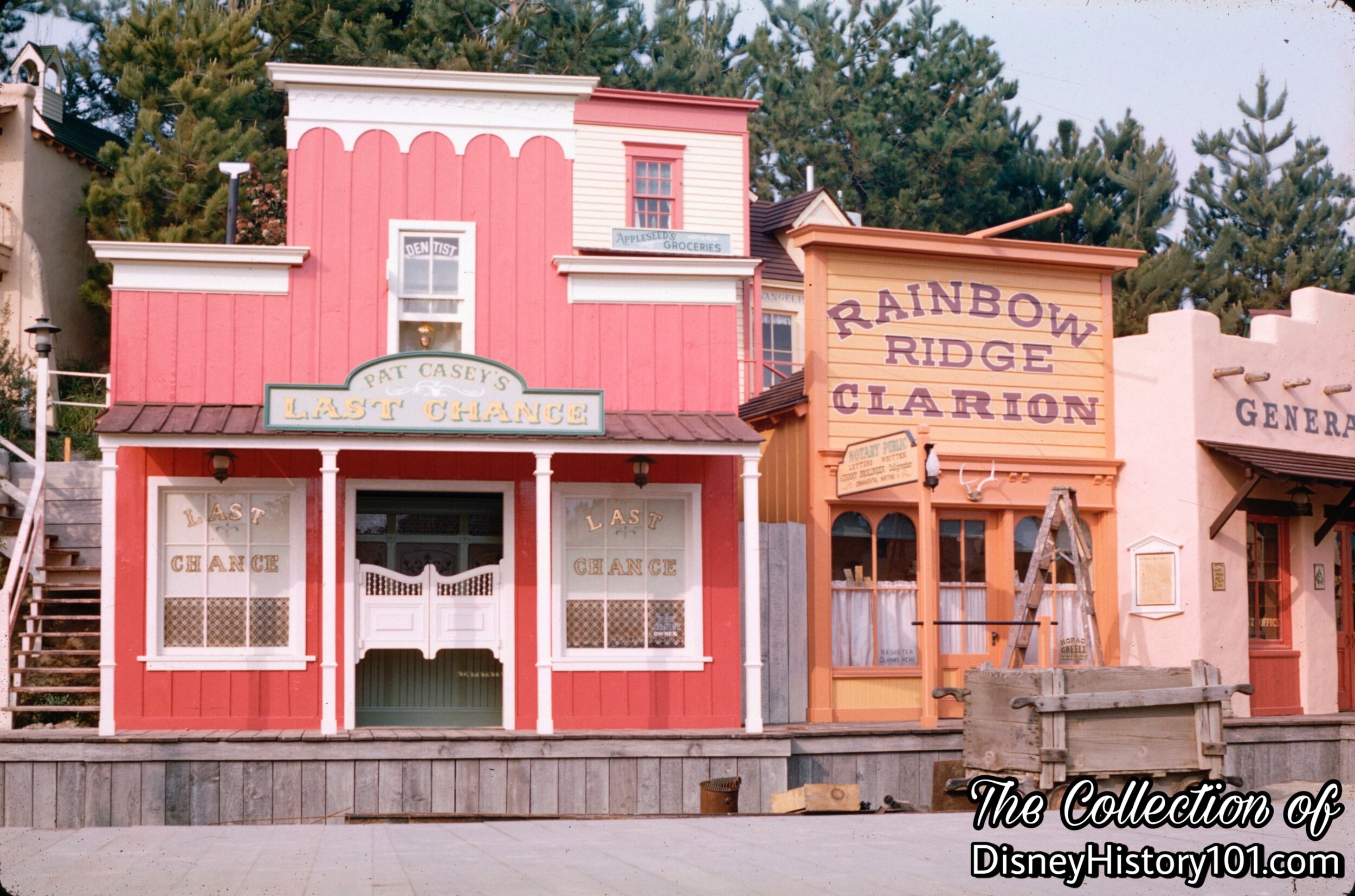
The sounds of the lively Rainbow Ridge can be heard as we make our way through town.
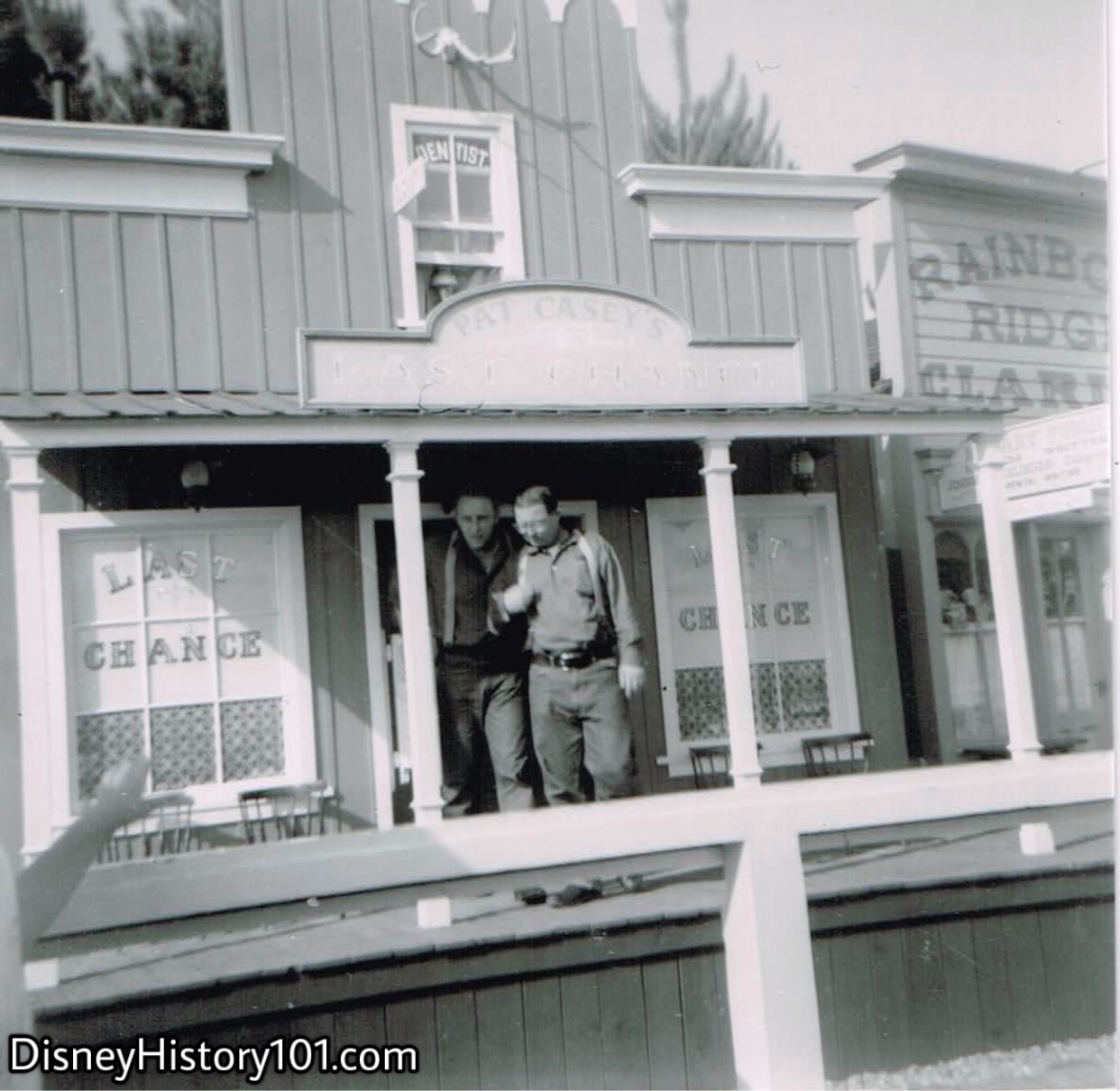
“Last Chance” for a couple of burly Mine Train engineers, before embarking on a routine excursion into Nature’s Wonderland!
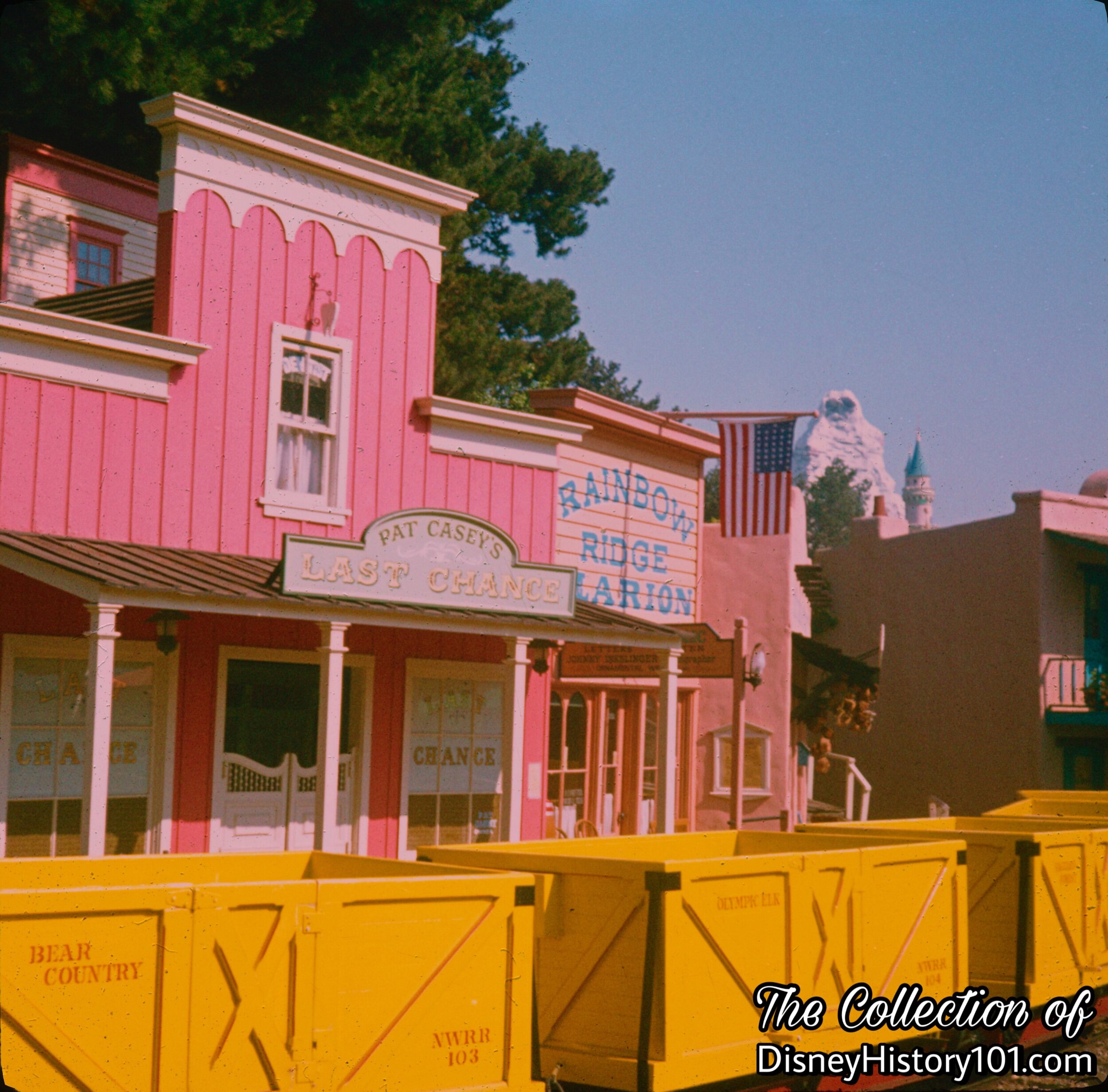
You can blame it on the Walt Disney Production. Like many Frontierland elements (like Pecos Bill and Slue Foot Sue), the look of Pat Casey’s Last Chance was partially derived from designs used in backgrounds created for the Pecos Bill segment of Melody Time (1948). As a final (and loyal) touch to set the Stage, 36-star flags hang around this little mining town!
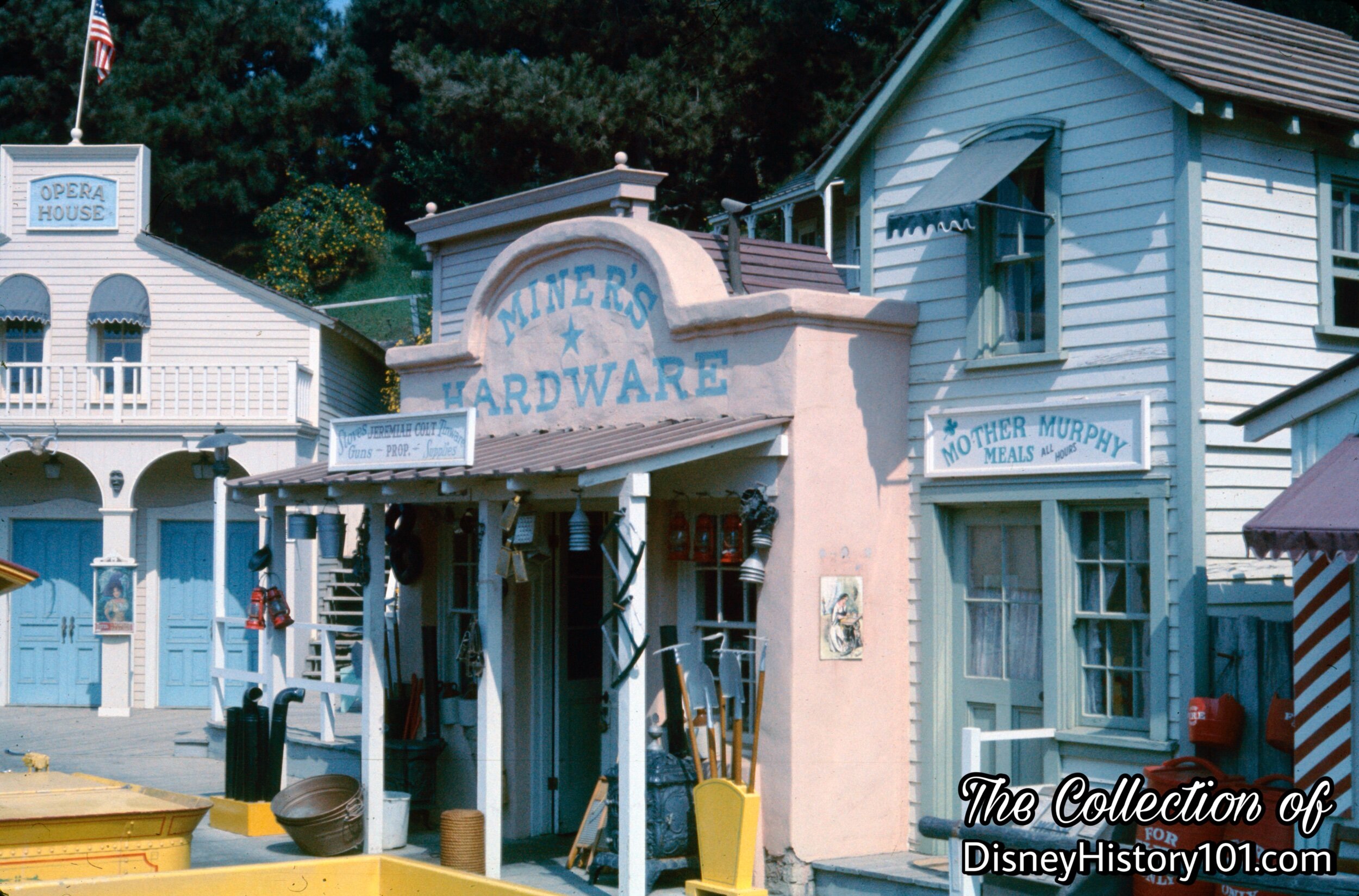
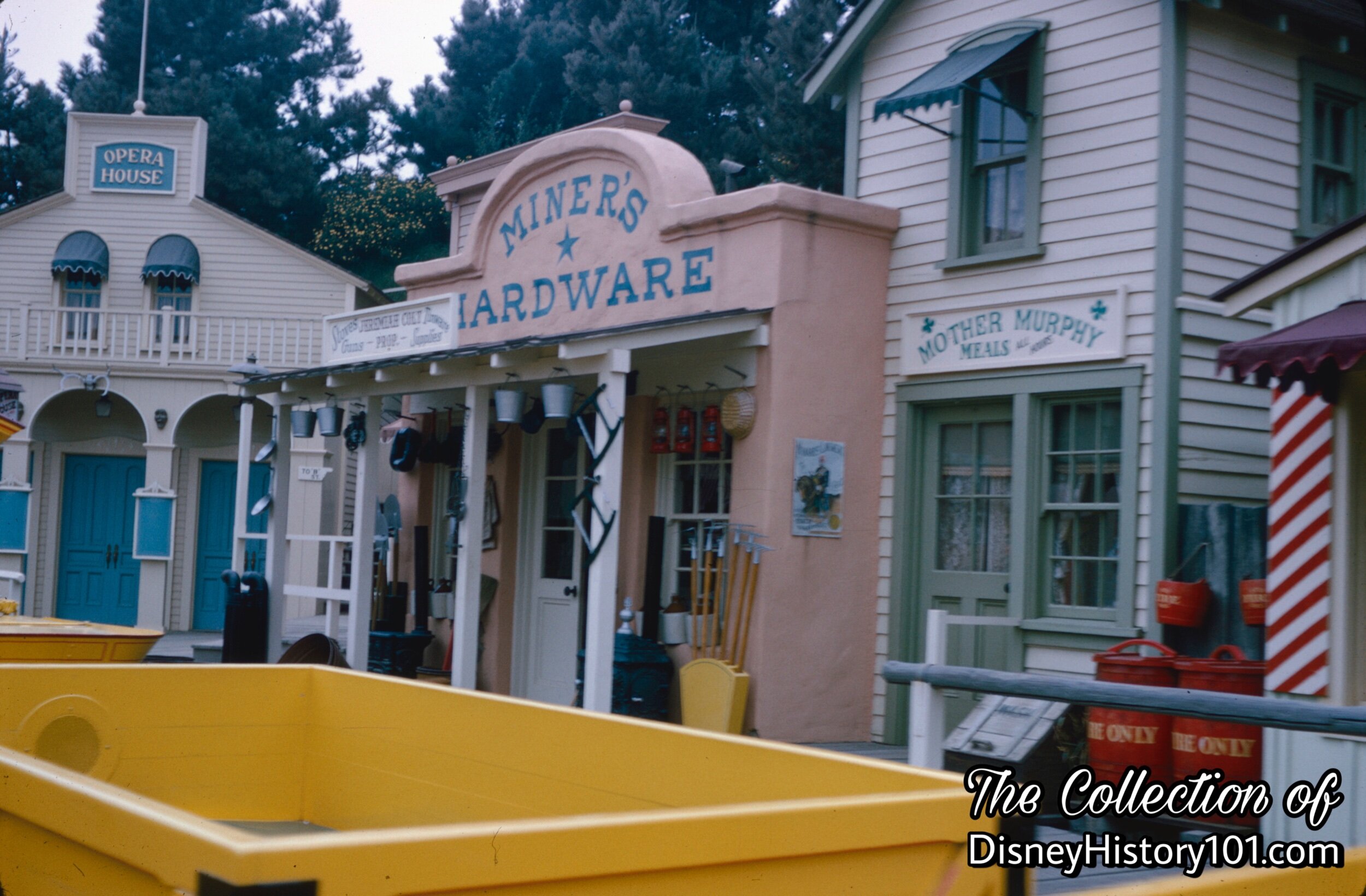


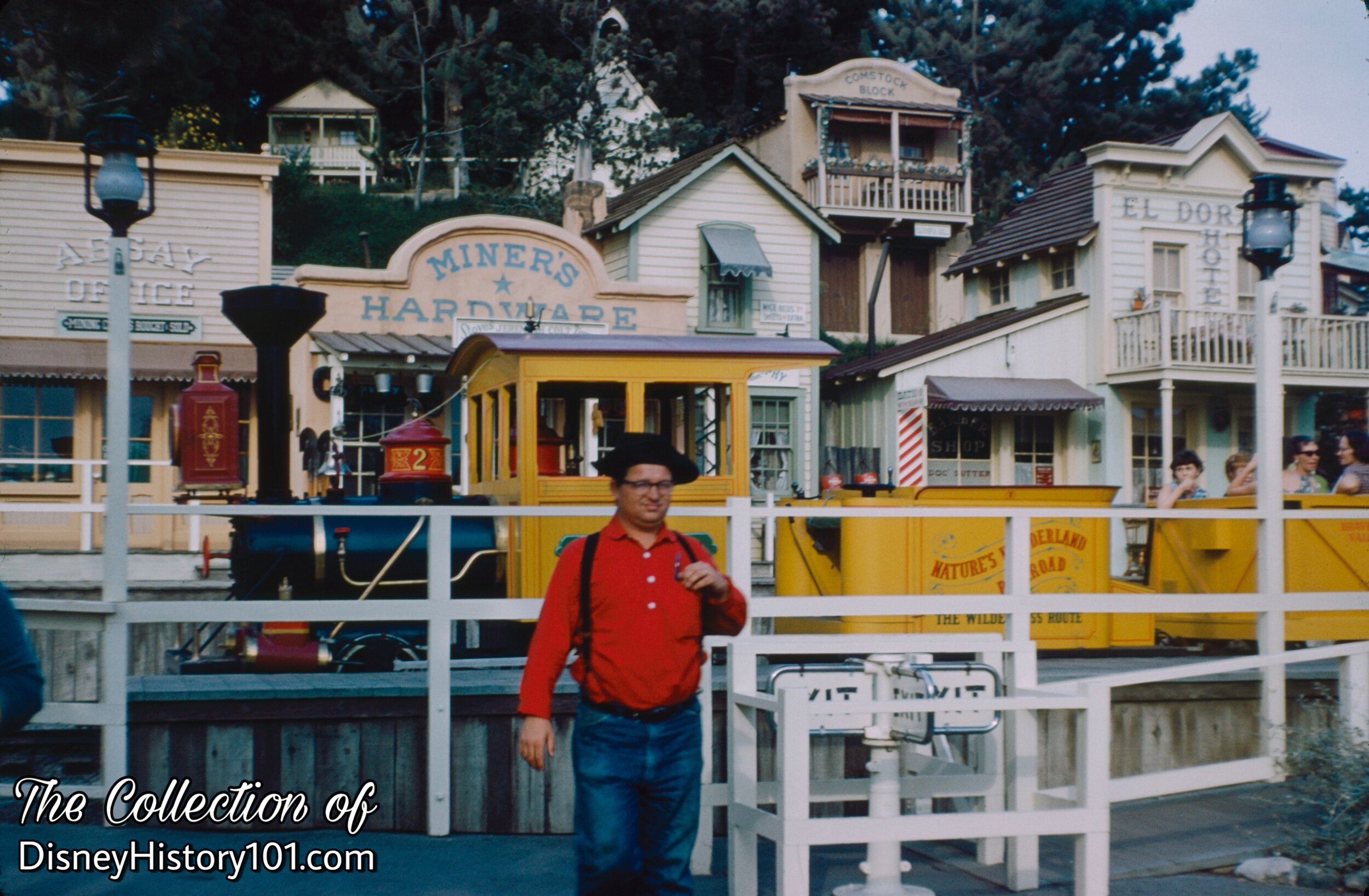
Before you come aboard, we’d like to introduce you to a very special Mine Train conductor Frank Mc Nell - an original and founding member of the Order of the Red Hankerchief - one of Disneyland’s oldest unsanctioned employee organizations! Thirty-six original members who operated the Mine Train Through Rainbow Caverns (like Ray Van de Warker) founded this organization during February of 1964. Many notable Disneylanders had a privileged part in the Mine Train rotation - the set order of operating positions established by the attraction's Working Lead. A total of 256 cast members would ultimately join (like George Kissinger, Clay Mitchell, John McCoy, and so many others). We just have one question - where’s Frank’s handkerchief?
Another distinguished title was that of “Most Mine Train Derailments”, a title held by Ron Dominguez (due to forgetting “to throw the switch”), according to accounts of Ray Van de Warker (to Disneyland LINE magazine, Vol. 25, No. 28). Ron Dominguez went from the Mine Train to the Director of Disneyland Operations.
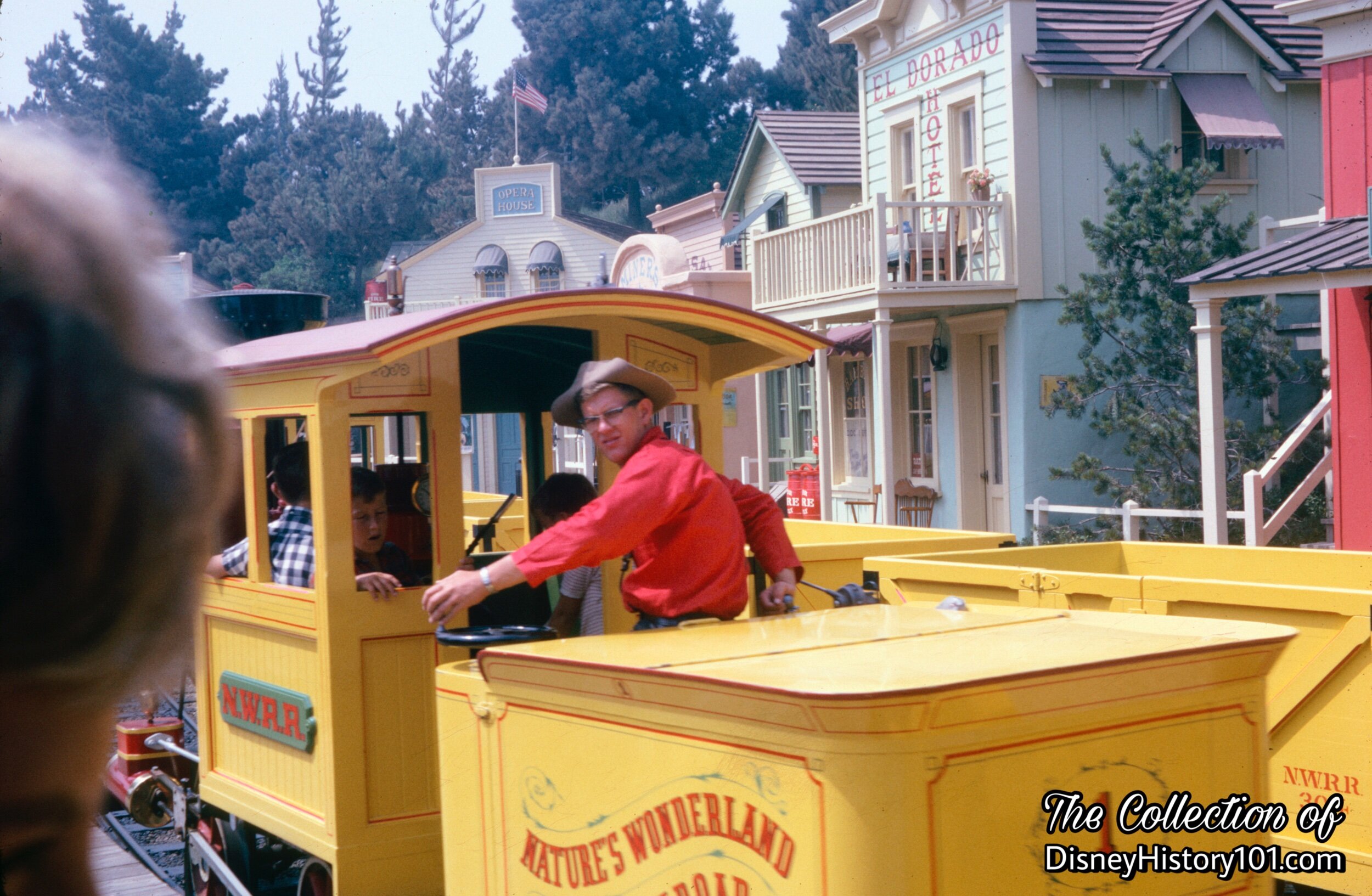
Many a Disneylander has operated a Mine Train, including Frank Block (c.1966; former Submarine Captain).
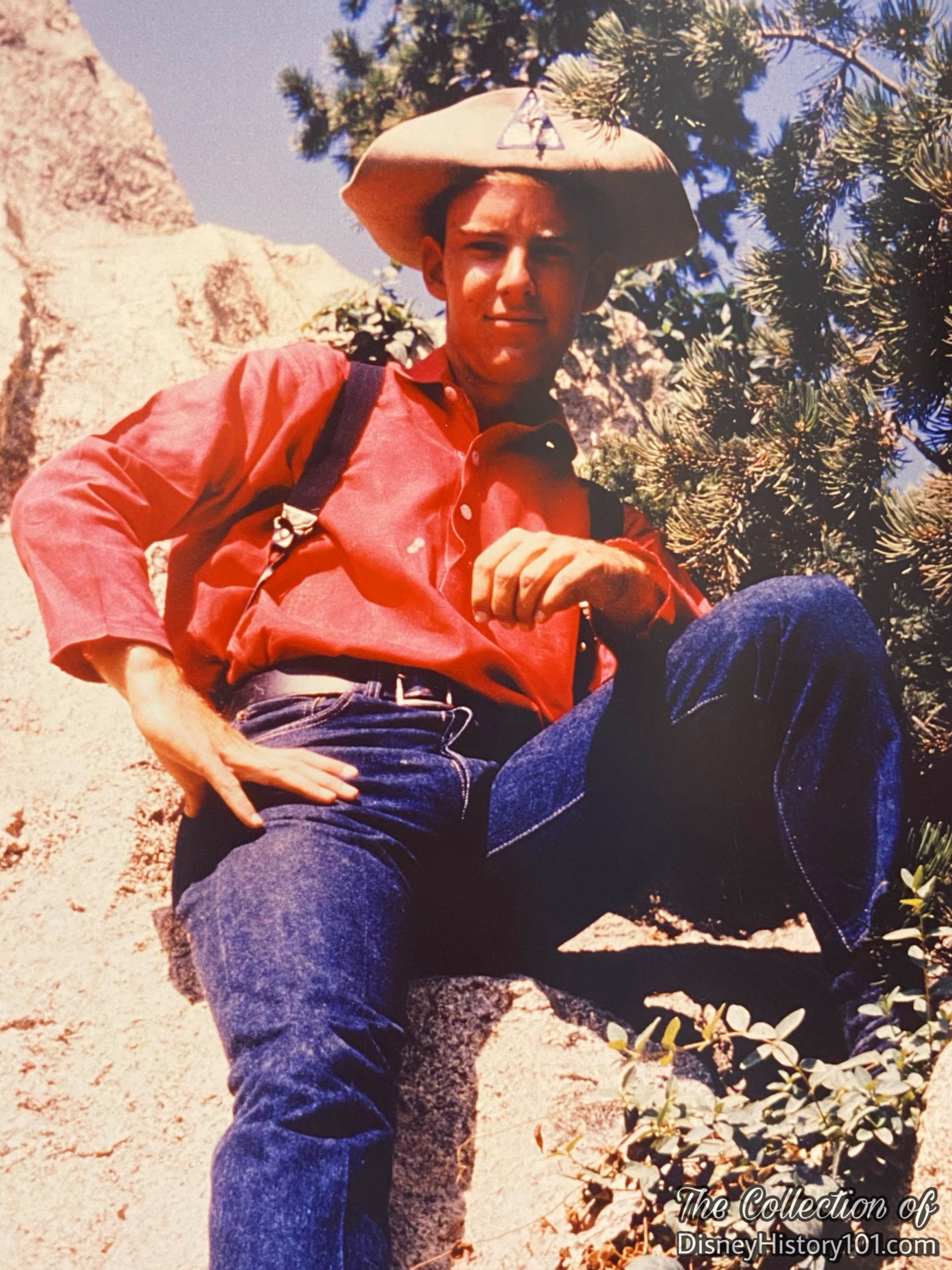
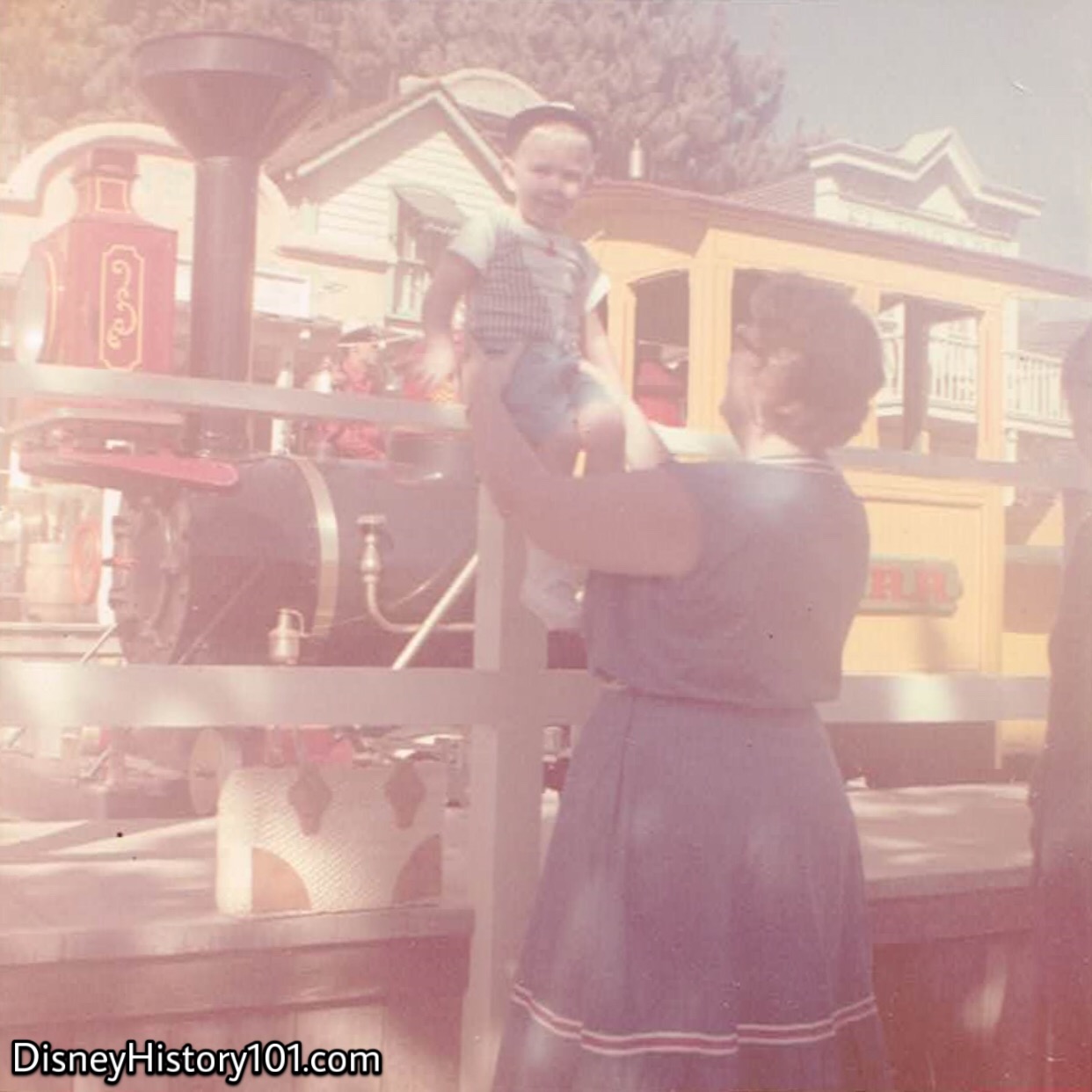
“As we head for the wilderness, a couple of suggestions - please stay seated at all times…”
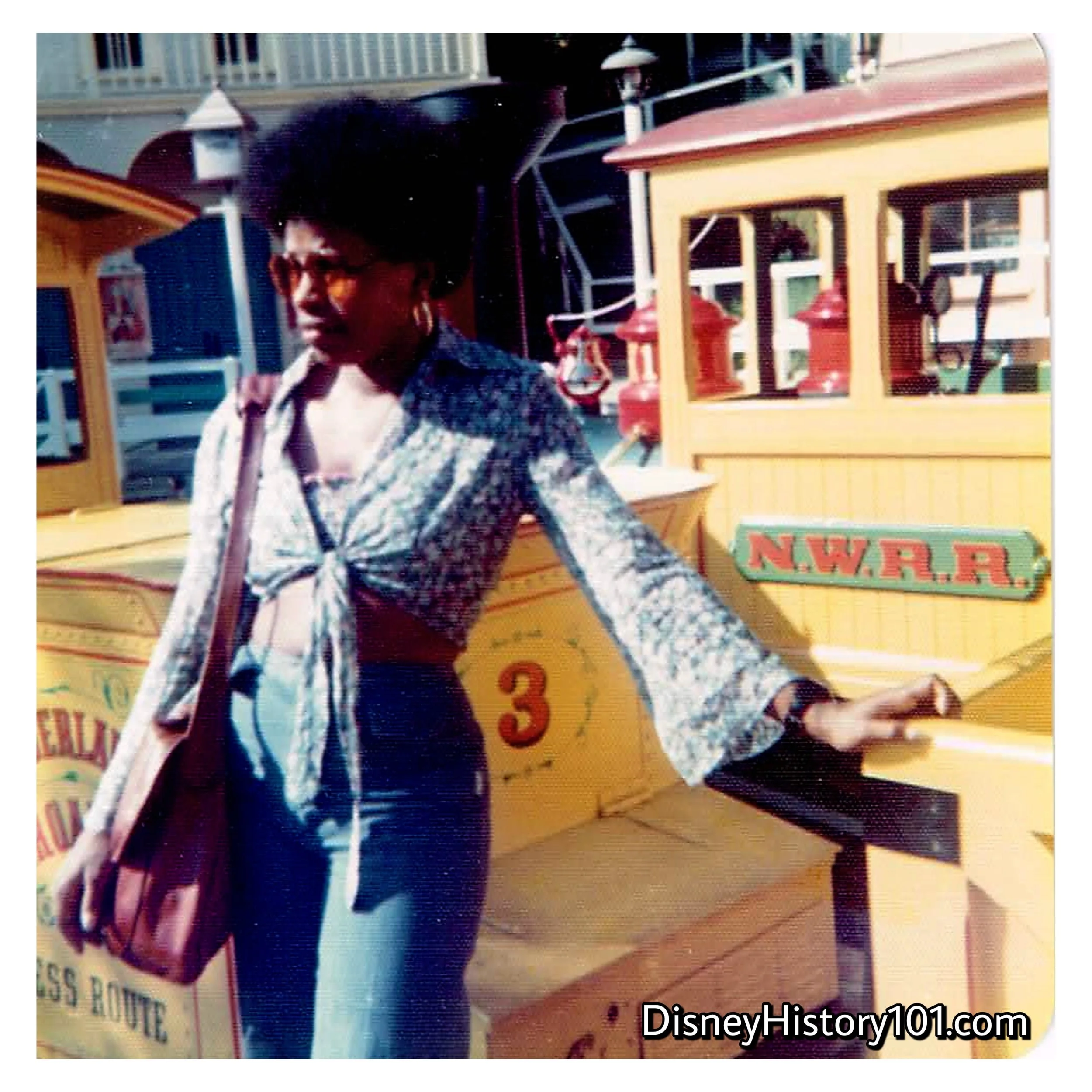
“…and [please] keep your hands and arms inside the train. The animals get mighty hungry. And uh, no smoking please, ‘cause we don’t want to start a forest fire.”
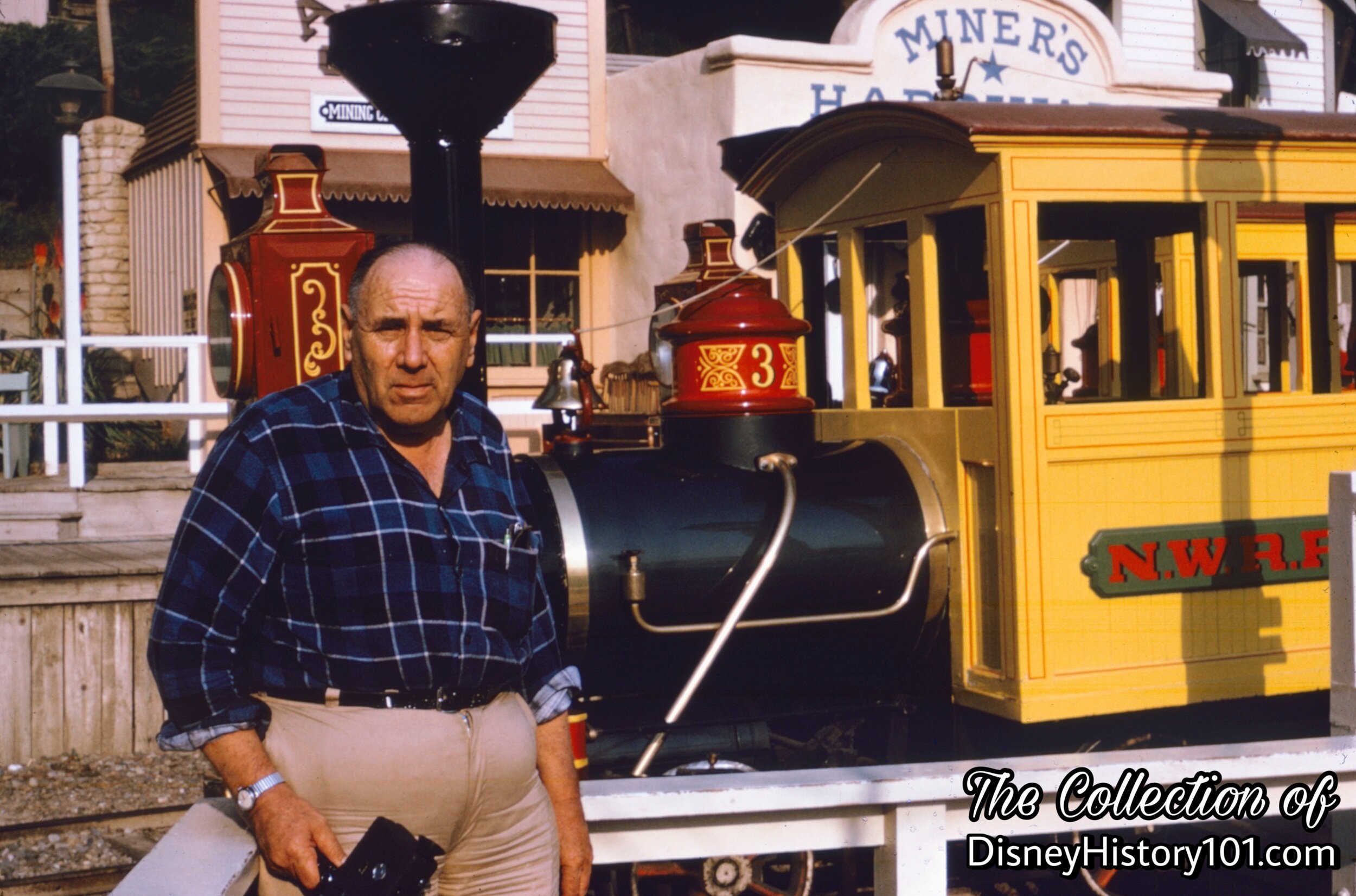
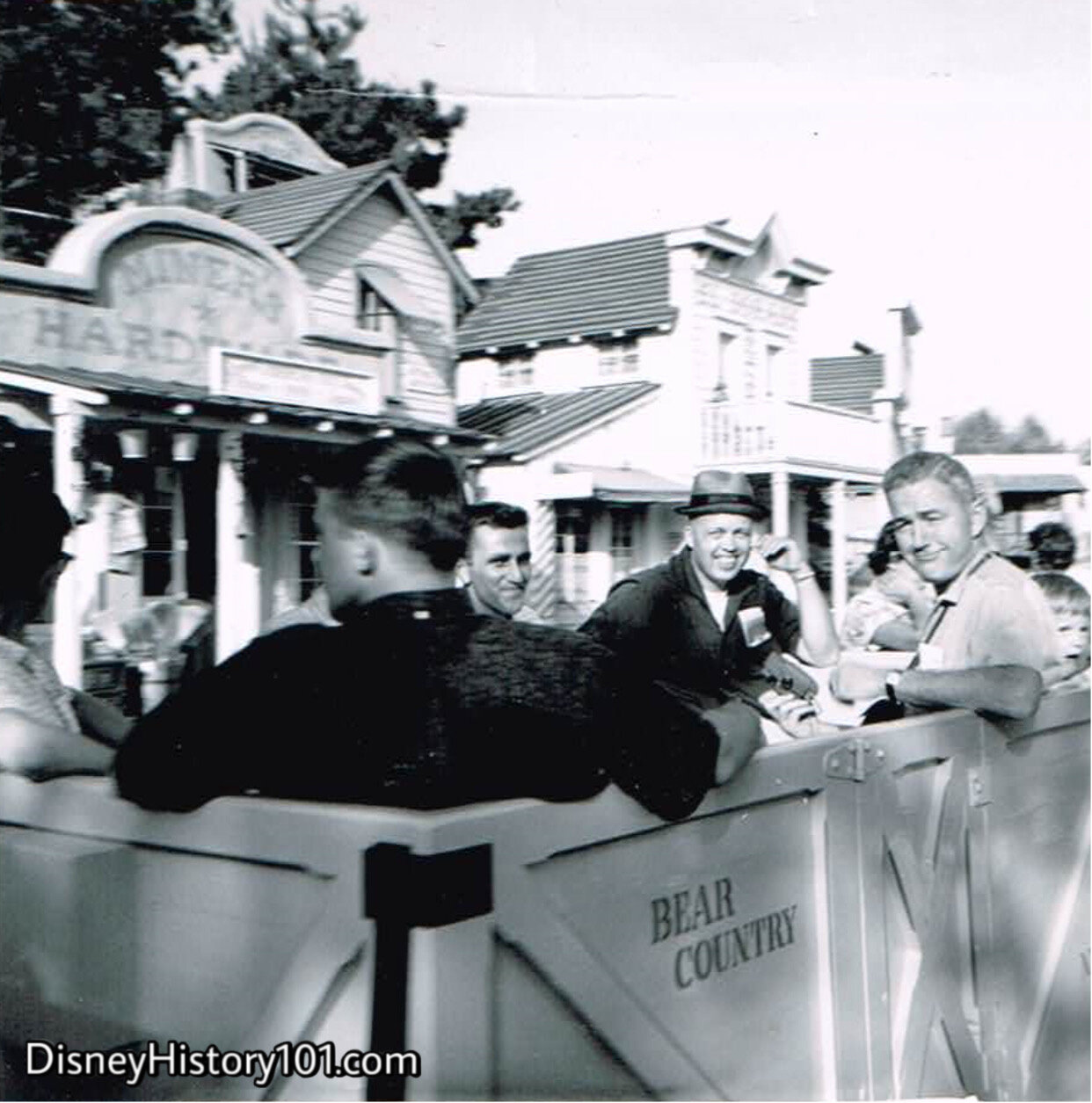
Guests are grouped, loaded, and (once aboard) the five gondola doors are safely “buttoned” closed. Once complete, the Ticket Receptionist hollers “All Aboard”, and a dispatch signal to the Engine Operator!
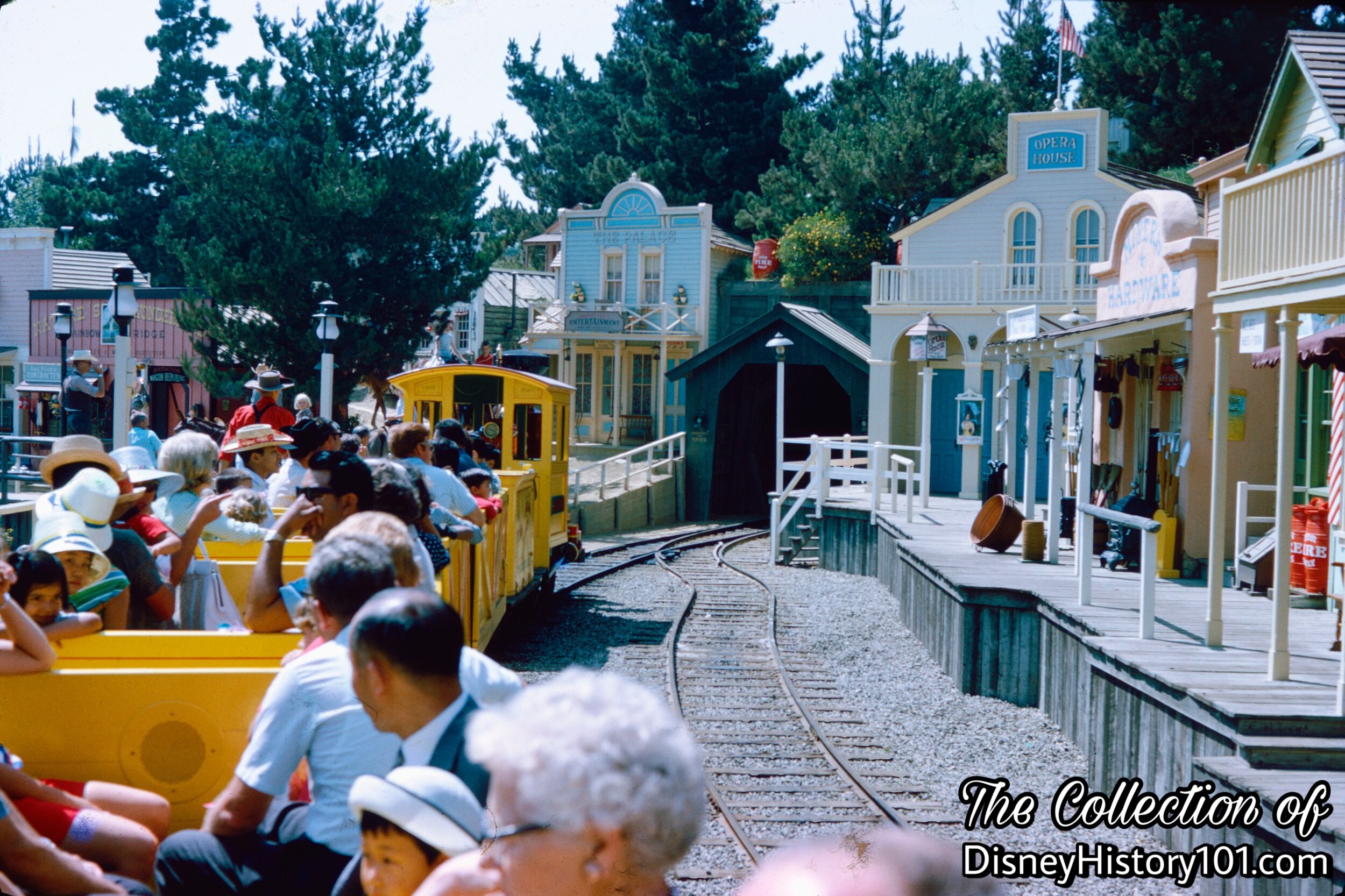
Now that each ten-passenger car is loaded to capacity, we’ll get on our way!
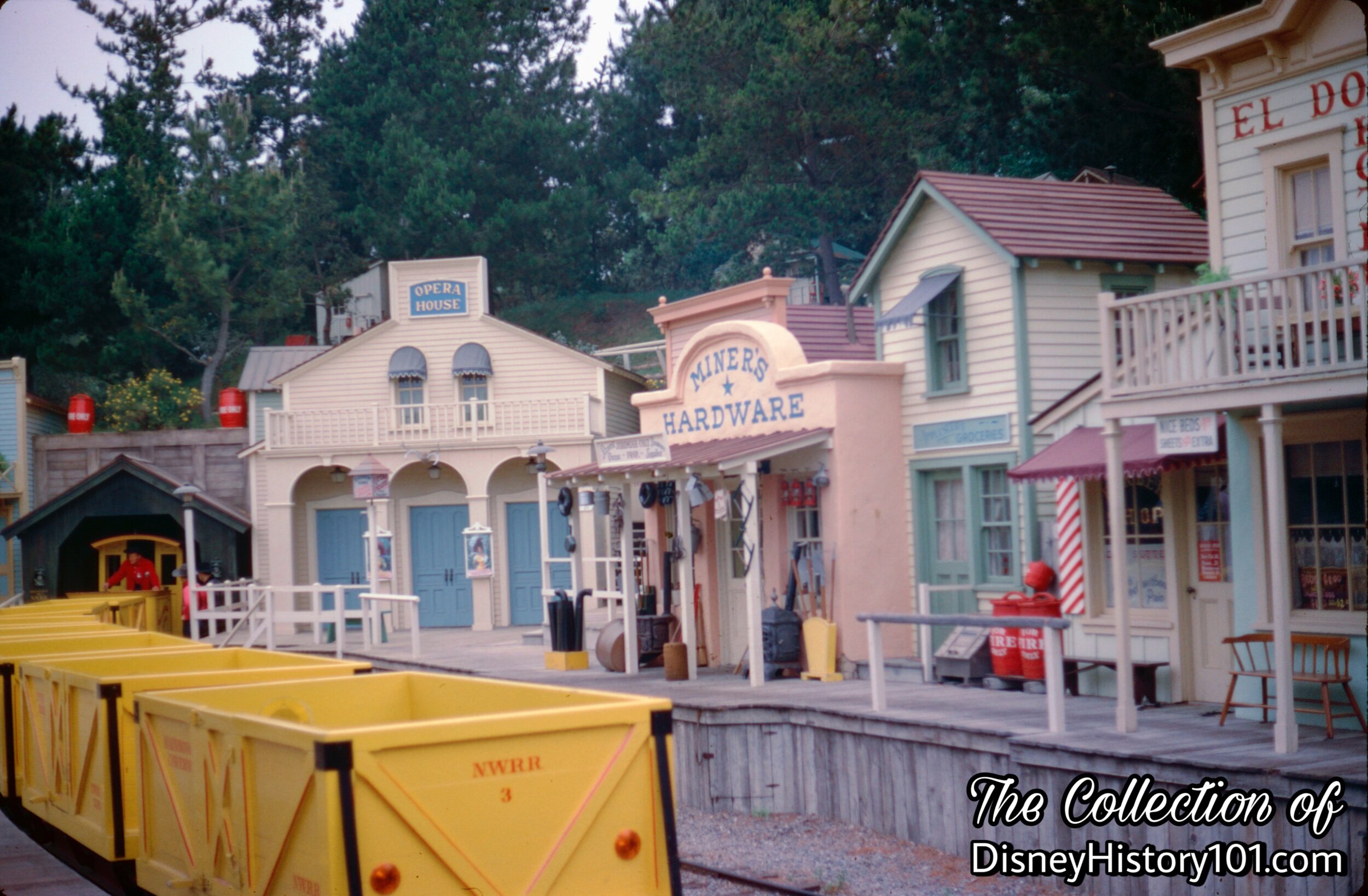
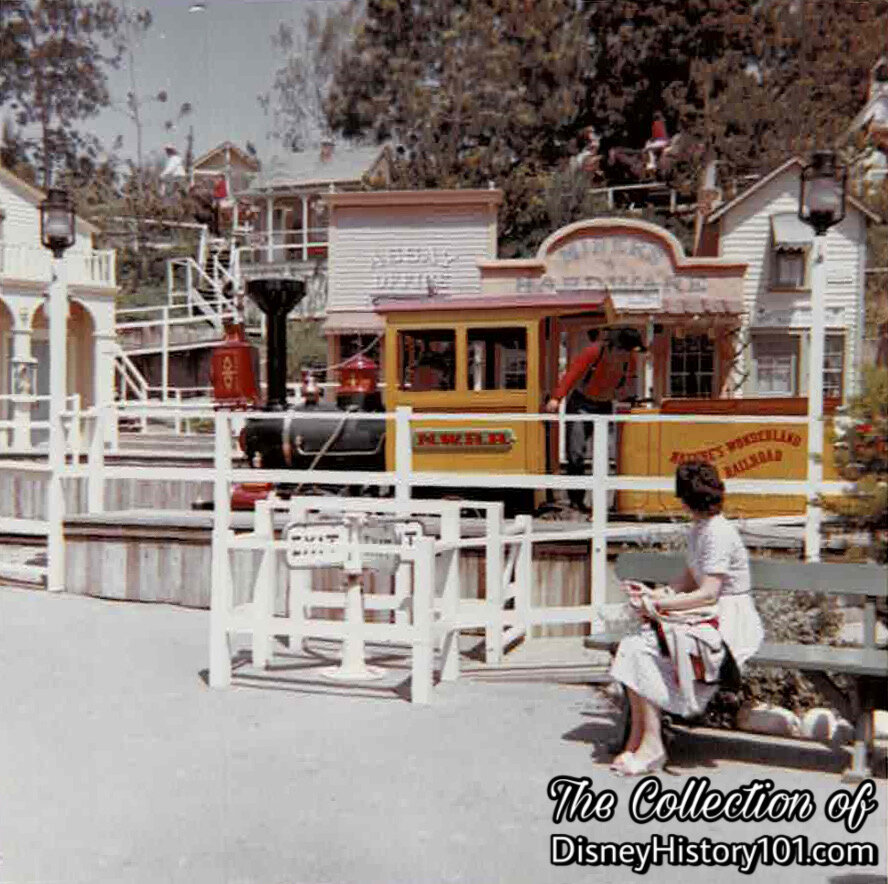
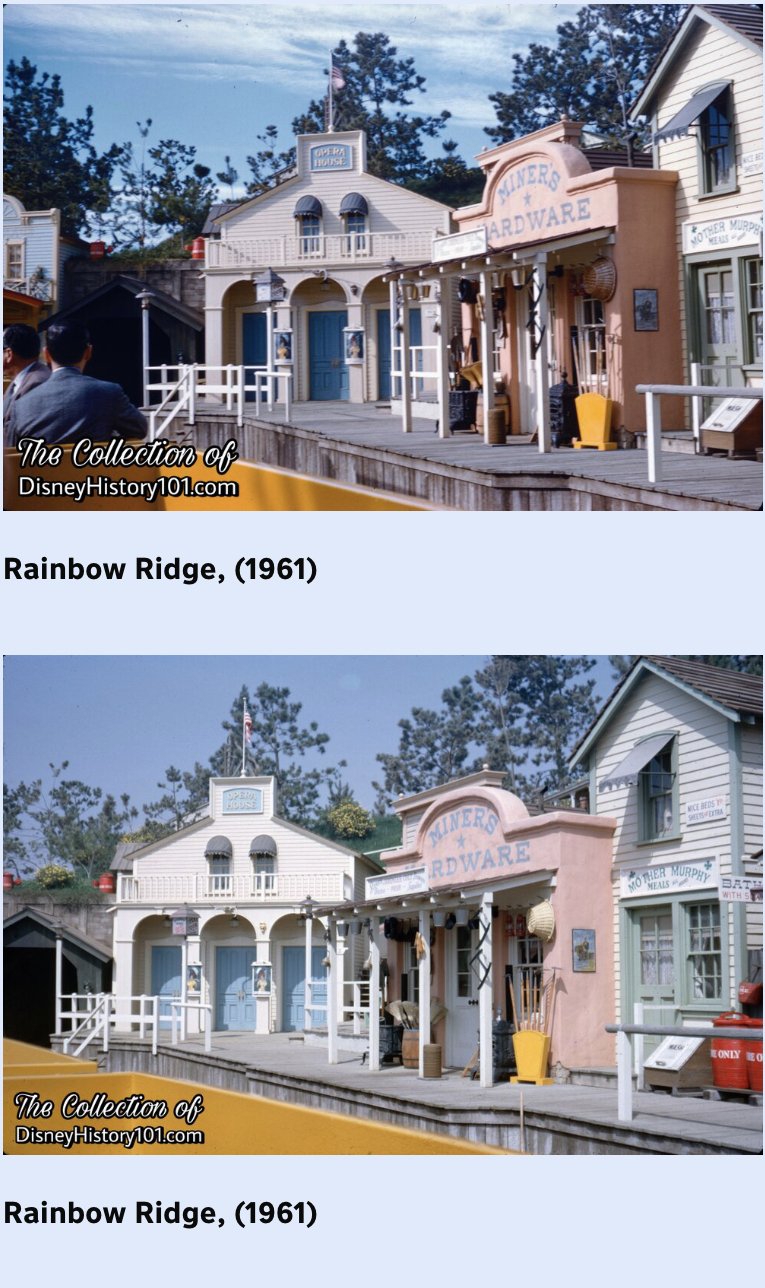
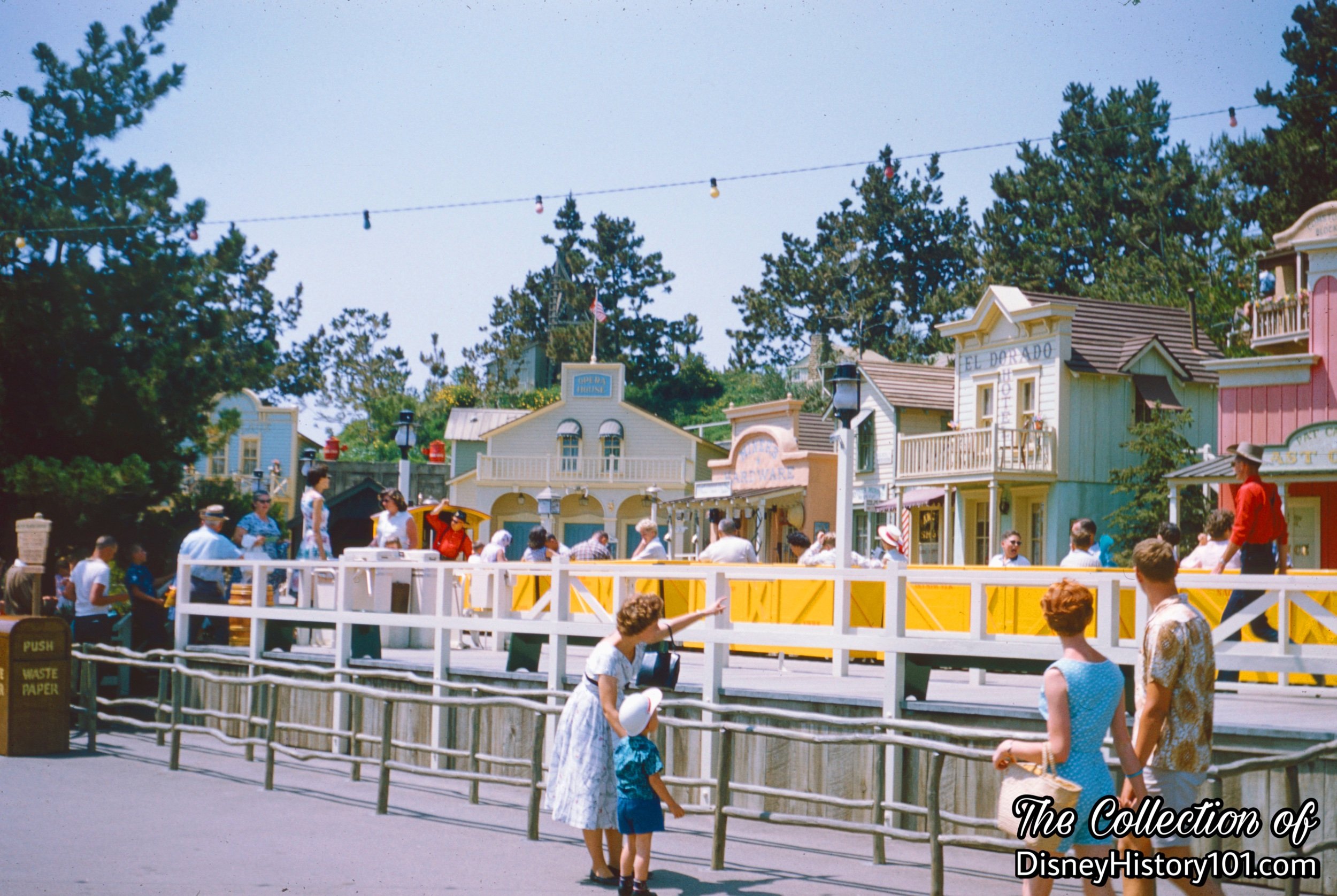
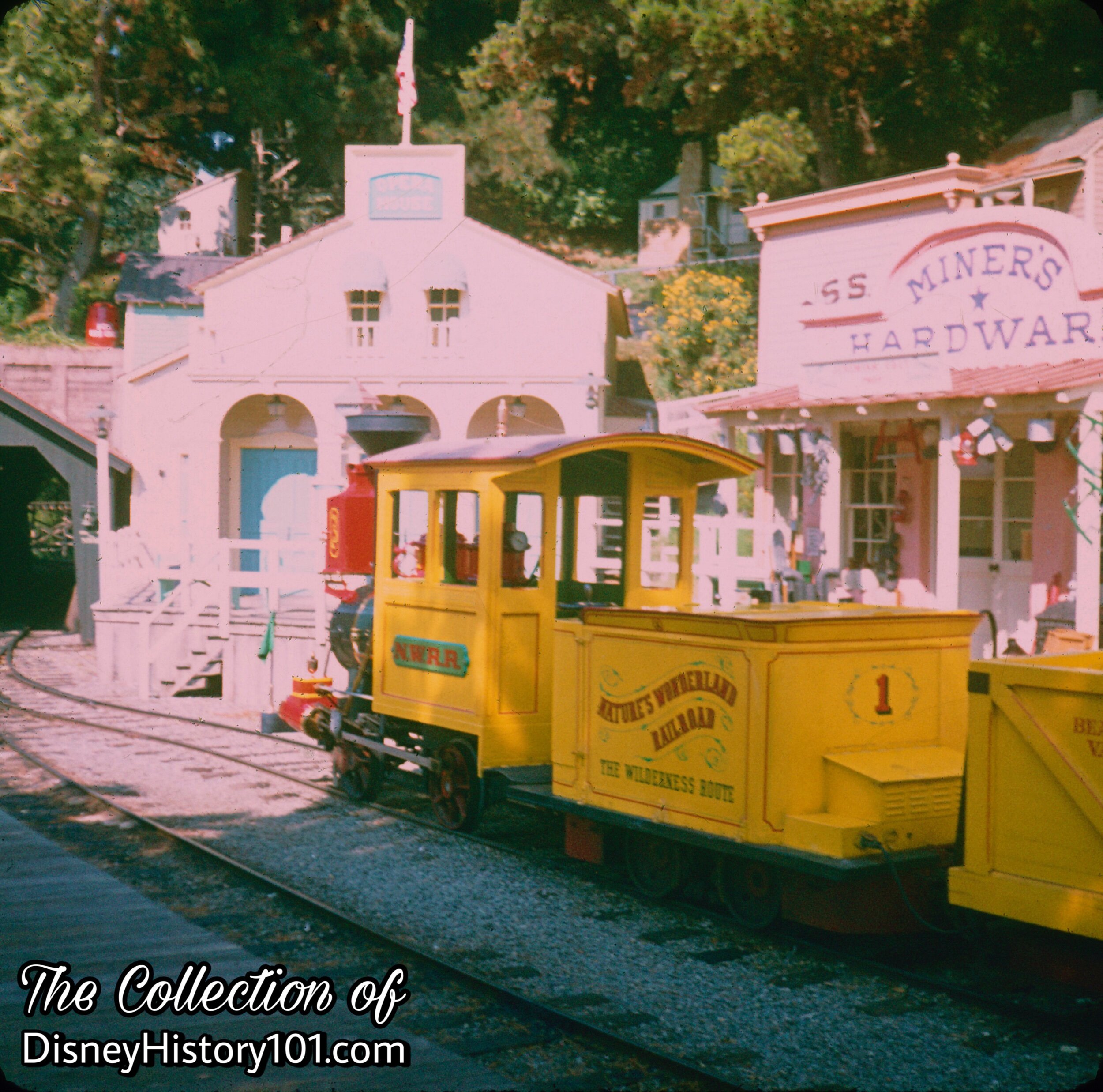
This is the “Center Stage” of Nature’s Wonderland’s big show, the boarding and unloading area - a typical little California mining town of California’s “gold rush era”! Today, mine train engines and gondolas from this era are typically observed in the Northern California area, (of course) with the exception of Disneyland’s bright and shiny Mine Train Thru Nature’s Wonderland, in Southern California.
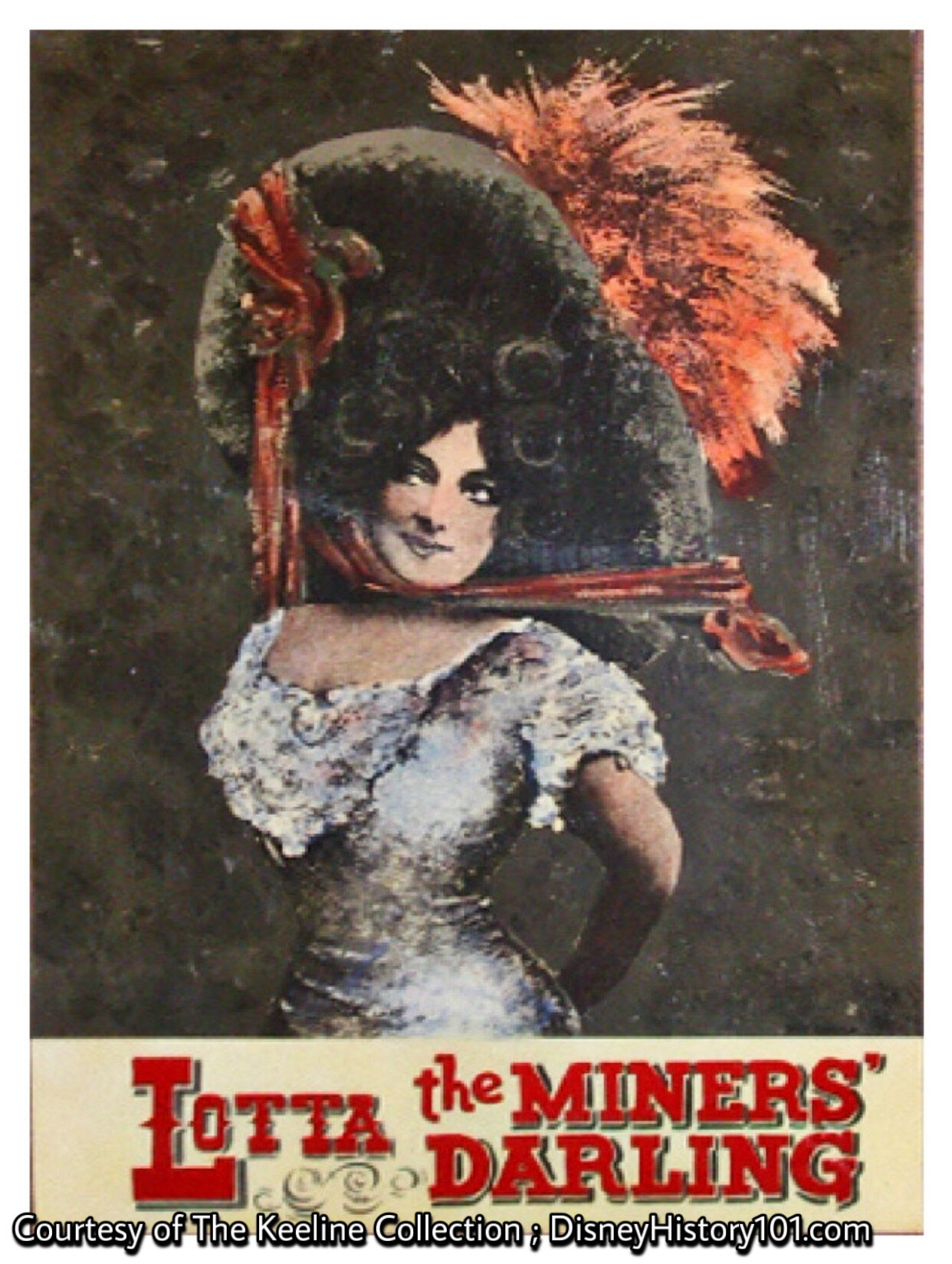
While the Golden Horseshoe Saloon has Slue Foot Sue, “Lotta the Miner’s Darling” performs daily (for your entertainment) in Rainbow Ridge. In fact that’s her voice emanating from the Raintbow Ridge Opera House now!
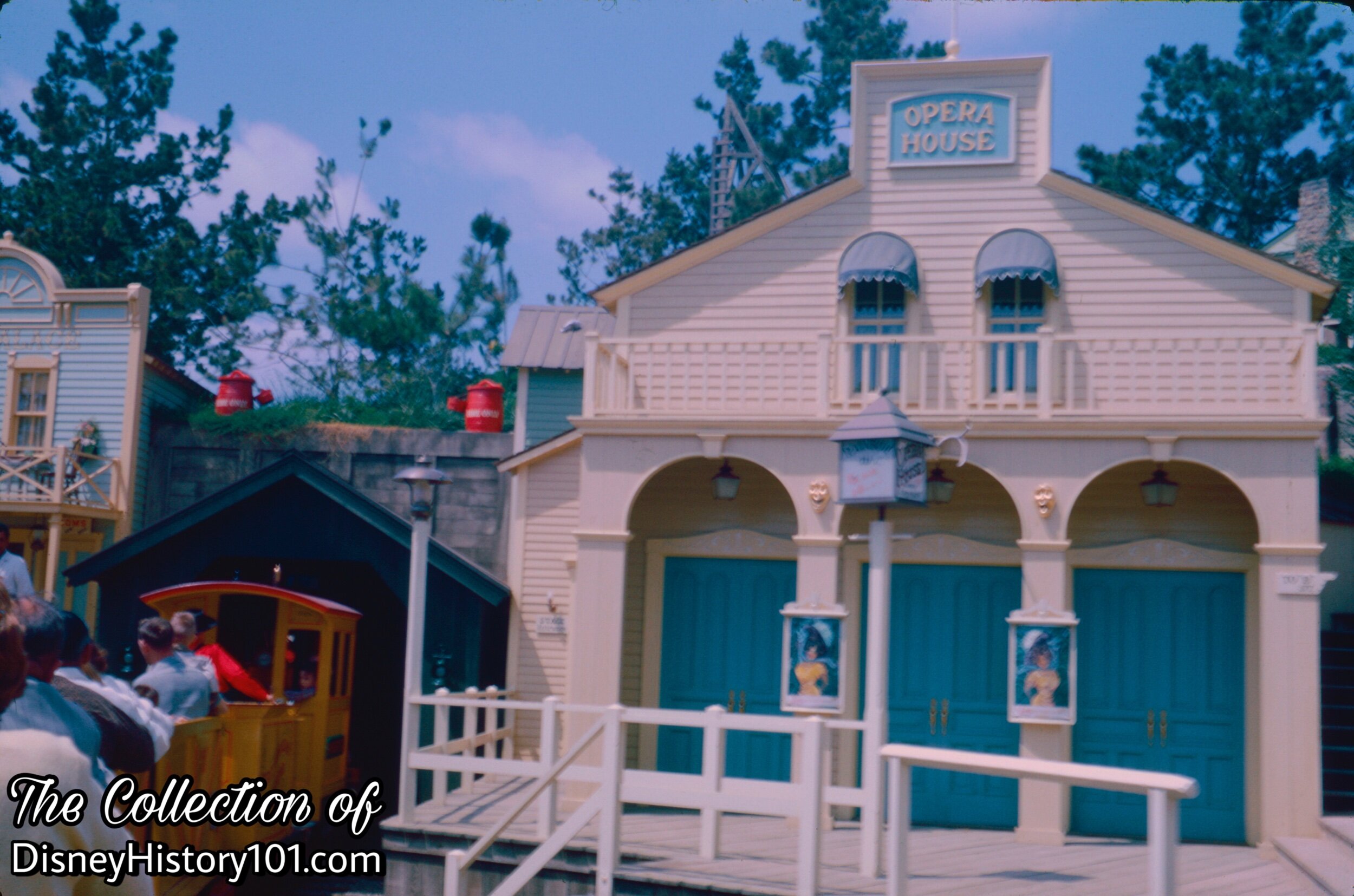
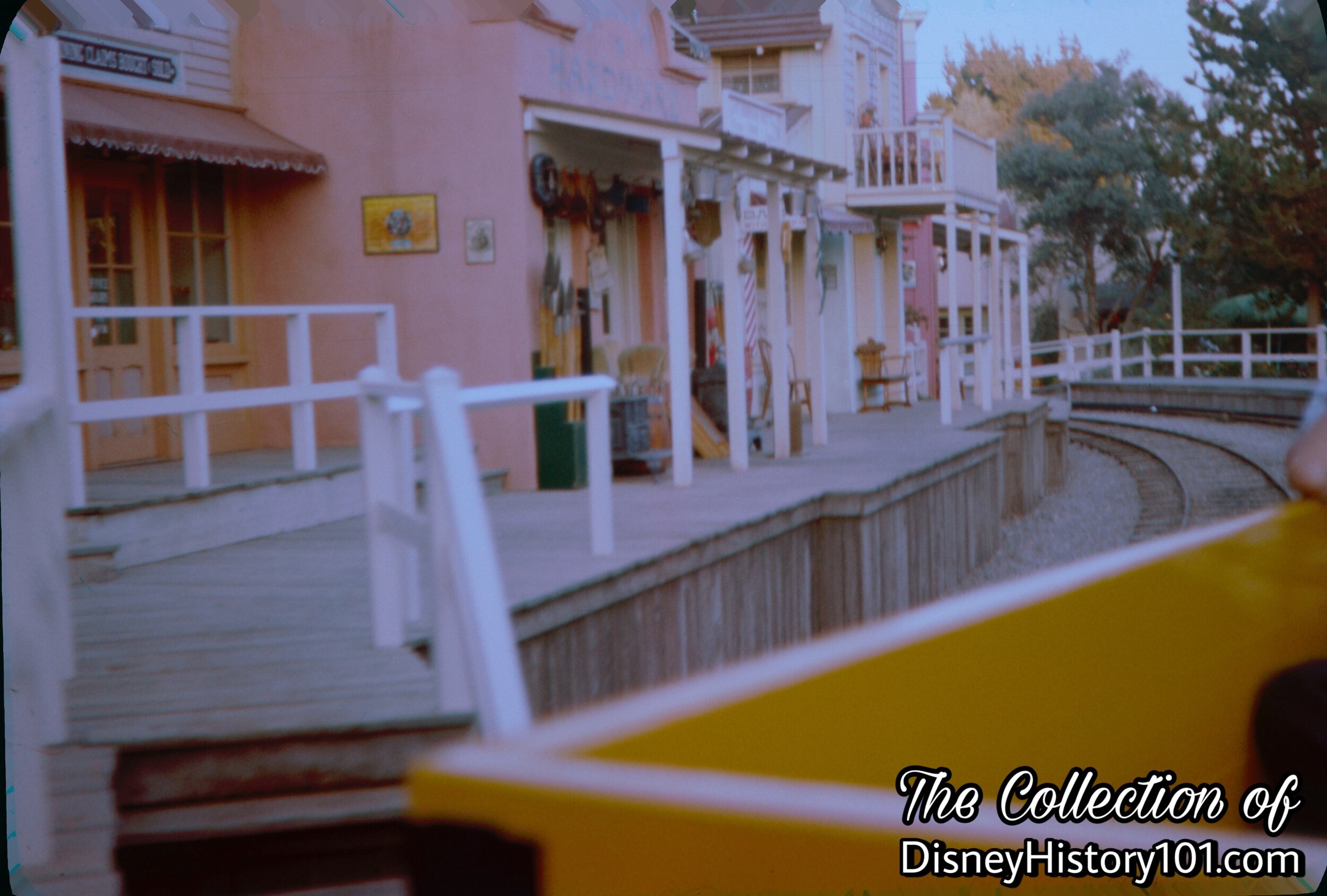
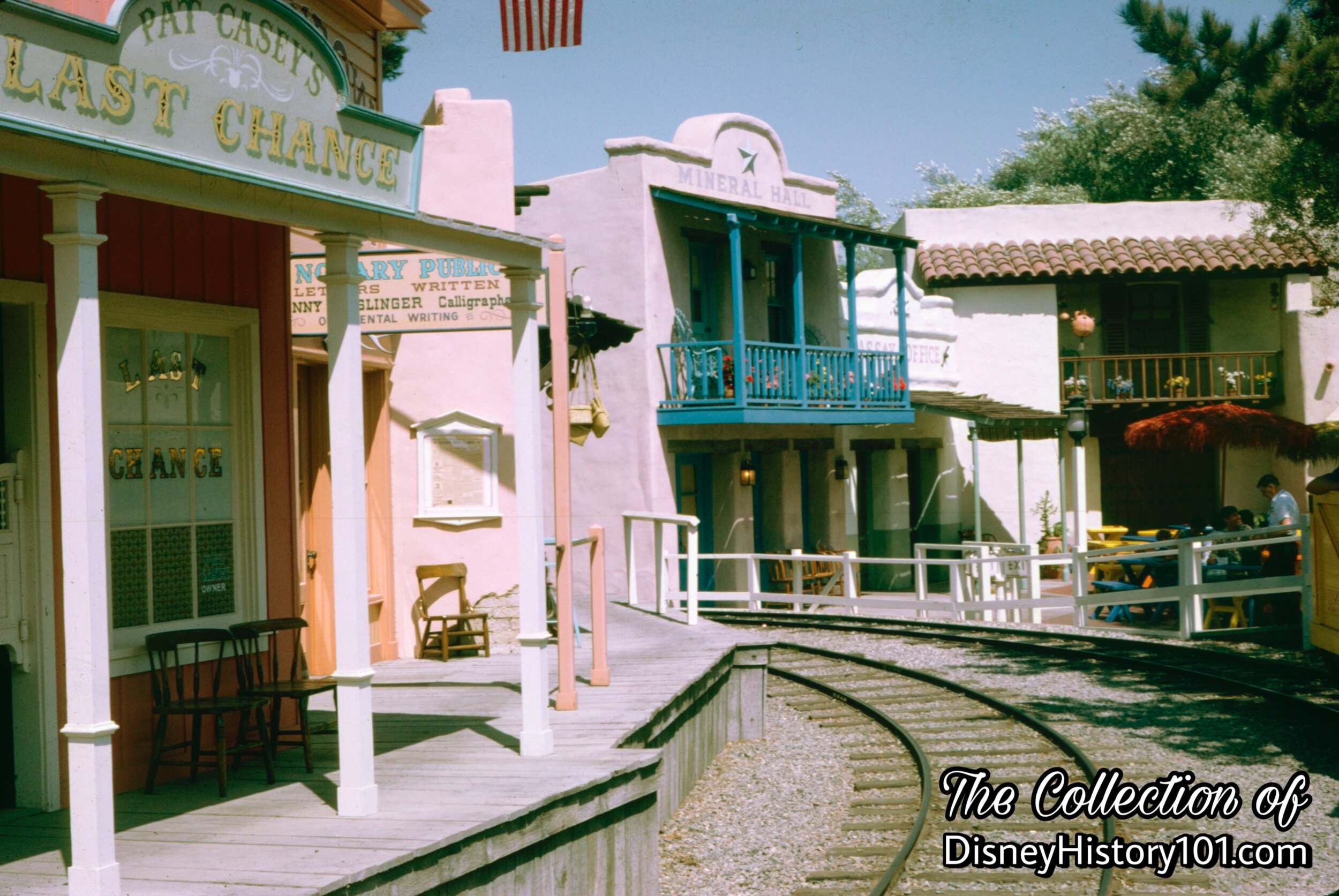
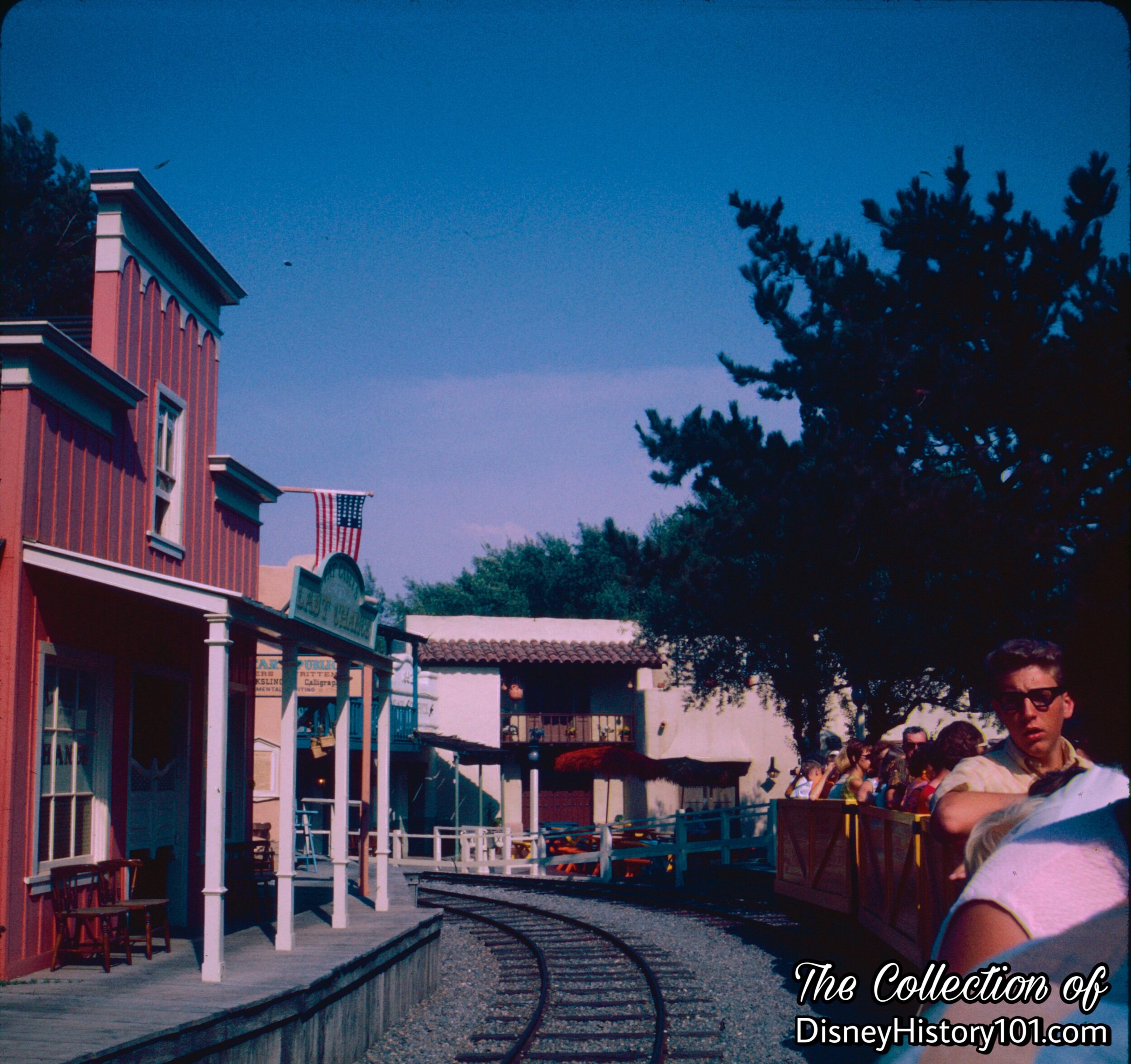
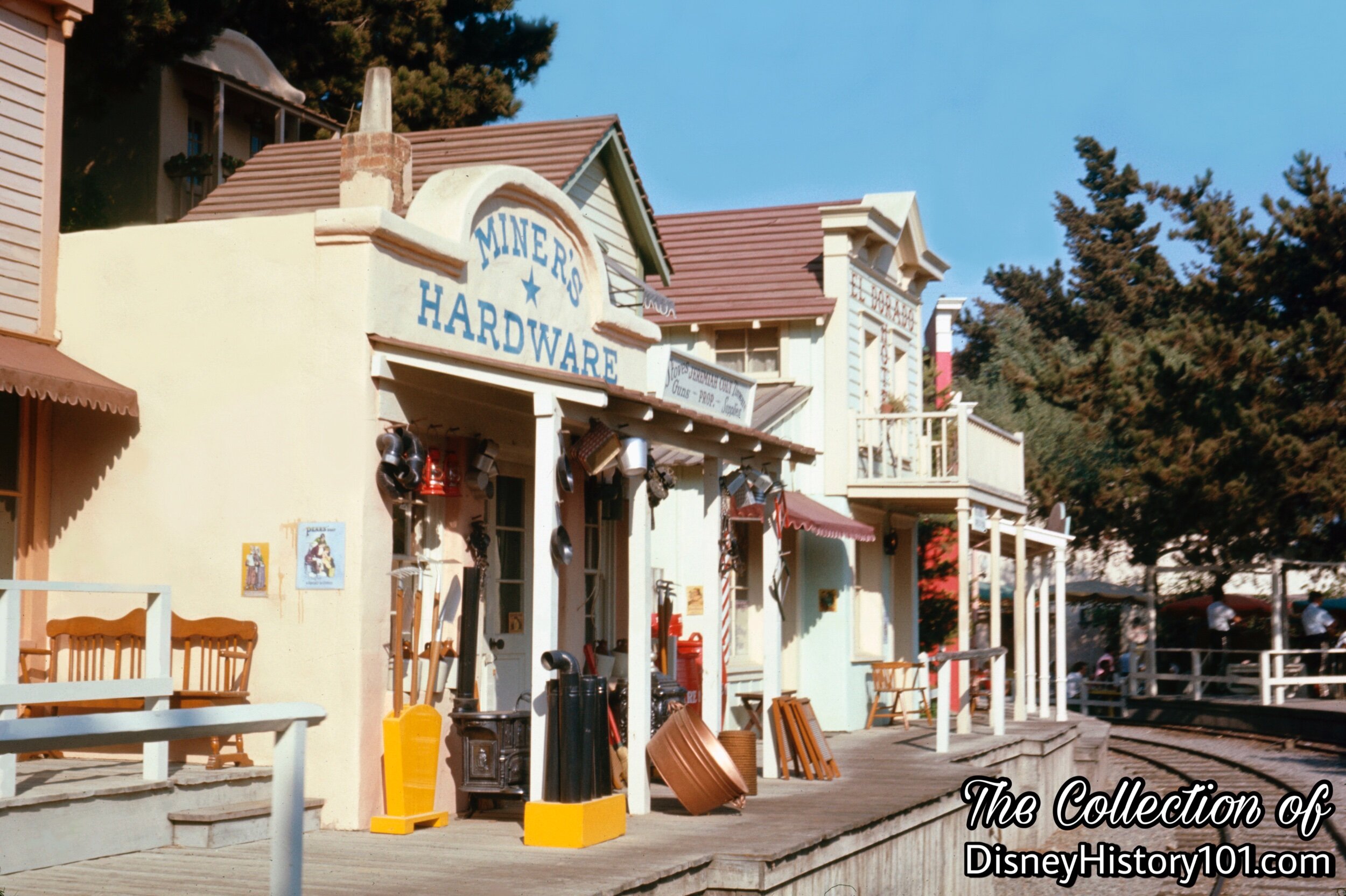
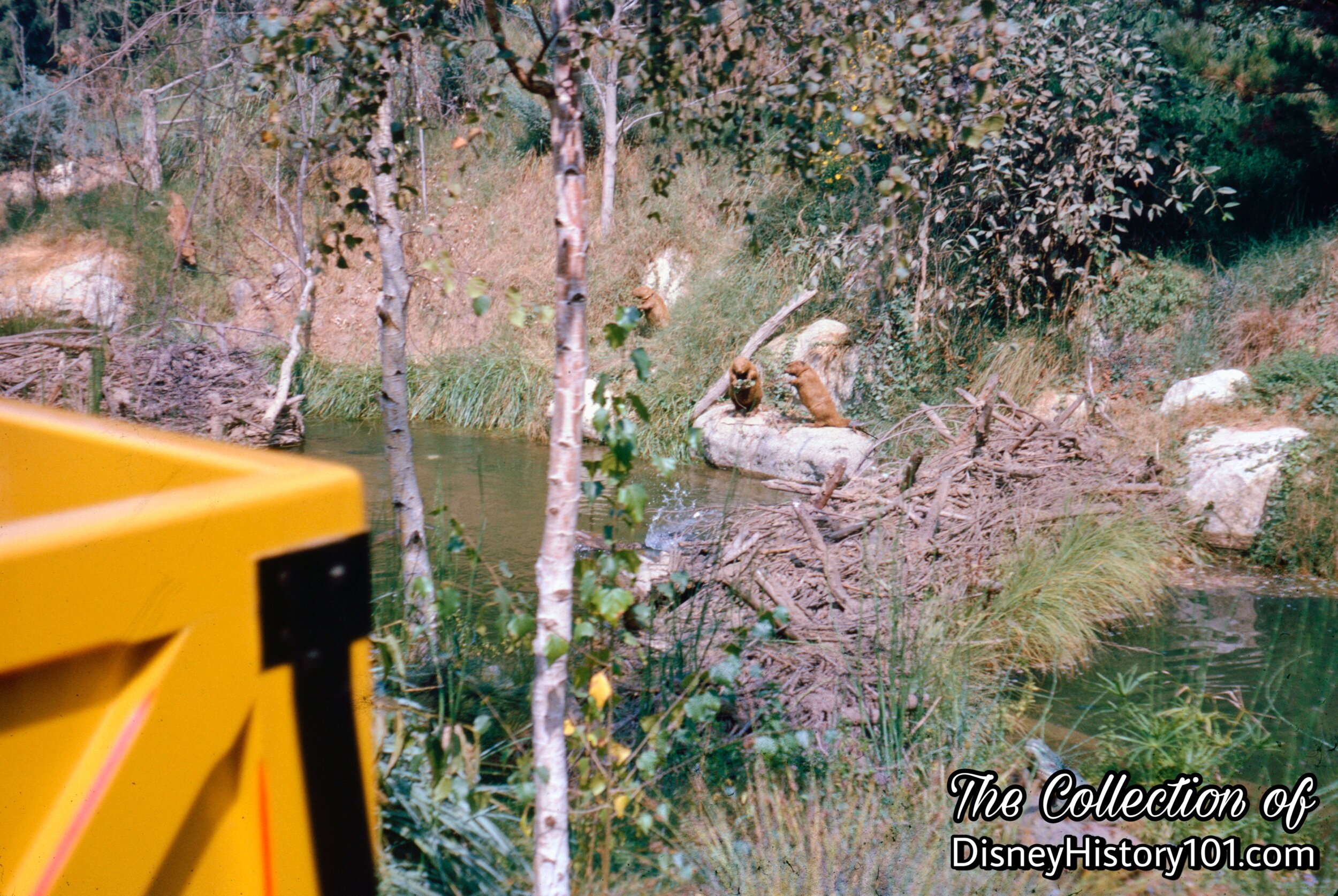
“As the passenger on the Nature's Wonderland Railroad emerges from the first tunnel on the mine ride, he sees beavers at work on their local dam project. Pine trees framing the scene are a mixture of Montereys from California and Aleppos from the Holy Land. The birch trees are from Europe, the cottonwoods from southwest United States. The mountain meadows of California supplied the thick stands of rushes found along the river. The other curious reed at the water's edge, known as "horsetail; is an old-time resident of the United States. It dates back about 40 million years, according to the paleontolo-gists. We also have native water primrose, which we inherited -it just crept out of the mud and joined us.” [Disneyland World of Flowers by Morgan Evans]
You may be wonderin’ who that little “rascal” is. “That little fellow…is one of your new friends in Nature’s Wonderland. No its not your foreman or supervisor ; its a Beaver, and he’s one of 200 of nature’s characters assigned to your stage,” according to Dick Nunis, Director of Operations. In fact, some 11 Beavers populate Nature’s Wonderland, turning heads, as they tug branches toward their dam, and dive in the water. Some of these show scenes were inspired by “In Beaver Valley,” 1951 Academy Award winning Best Two-Reel Subject of 1950.
You know, Walt Disney once said, “Animals have personalities like people and must be studied,” [Wisdom magazine, December, 1959]. “As we come out of this first tunnel, we’ll be entering Beaver Valley…”. It looks like these little fellows are “busy as a beaver”. Walt shared one observation and lesson he’d learned from the beaver this way: “Everyone needs deadlines. Even the beavers. They loaf around all summer, but when they are faced with the winter deadline, they work like fury. If we didn’t have deadlines, we’d stagnate.”
Speaking of deadlines, we’d better keep this scheduled train tour on the move.
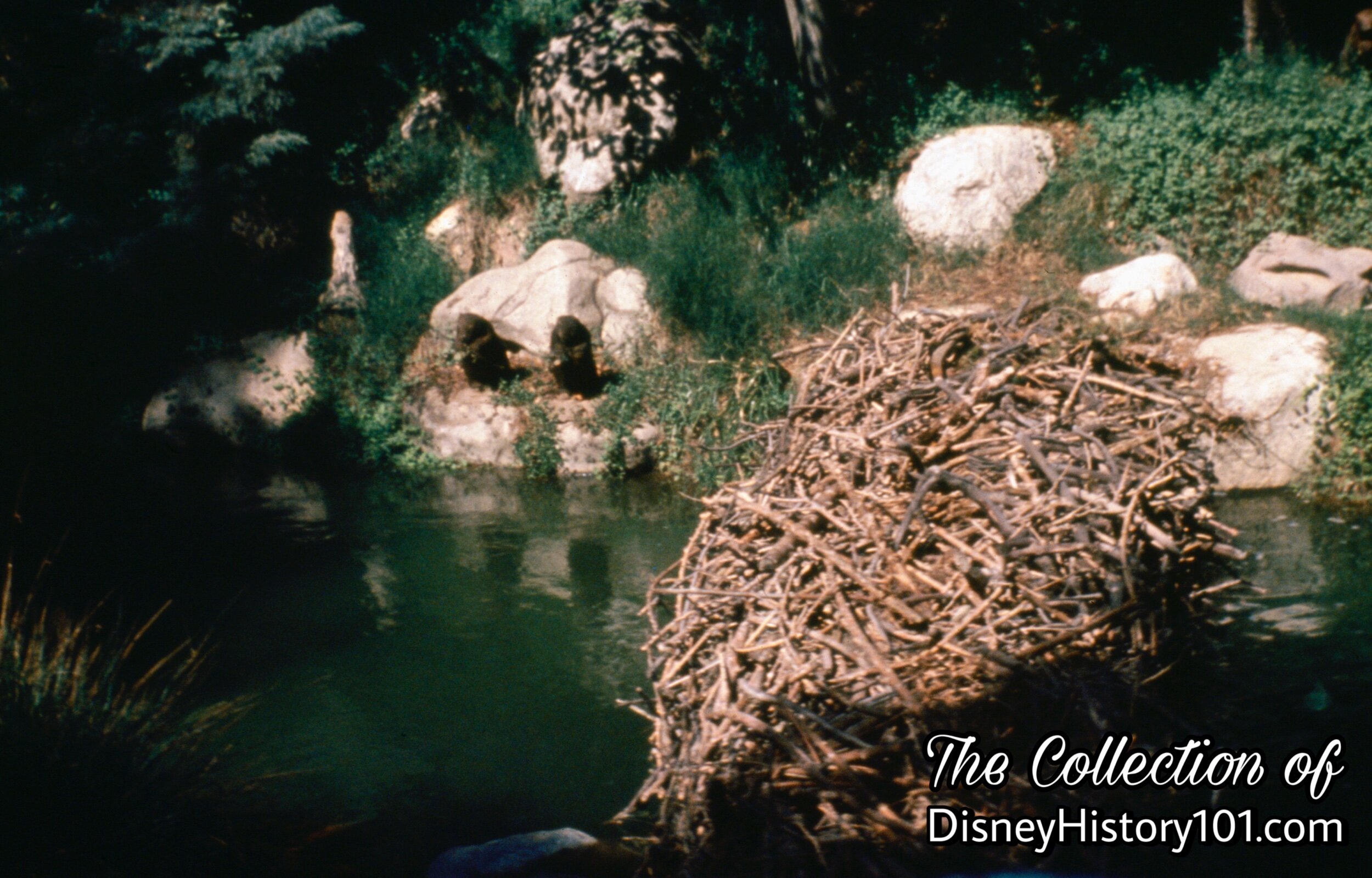
You know what sends these waters over the dam? In reality, a 65 horsepower pump produces more than 3,800 gallons of water over Beaver Valley waterways, per minute. Some of the effects are owed to the power of water. “Beavers building a dam…swimming, diving, and carrying branches to their home in life-like fashion, these beavers are moved along on underwater tracks by means of a water jet. The flow from the jet is kept constant, assuring a smooth swimming action, by a pressure-reducing valve which is hidden and partially submerged in the beaver dam”, according to one ServiSoft Exchange periodical.
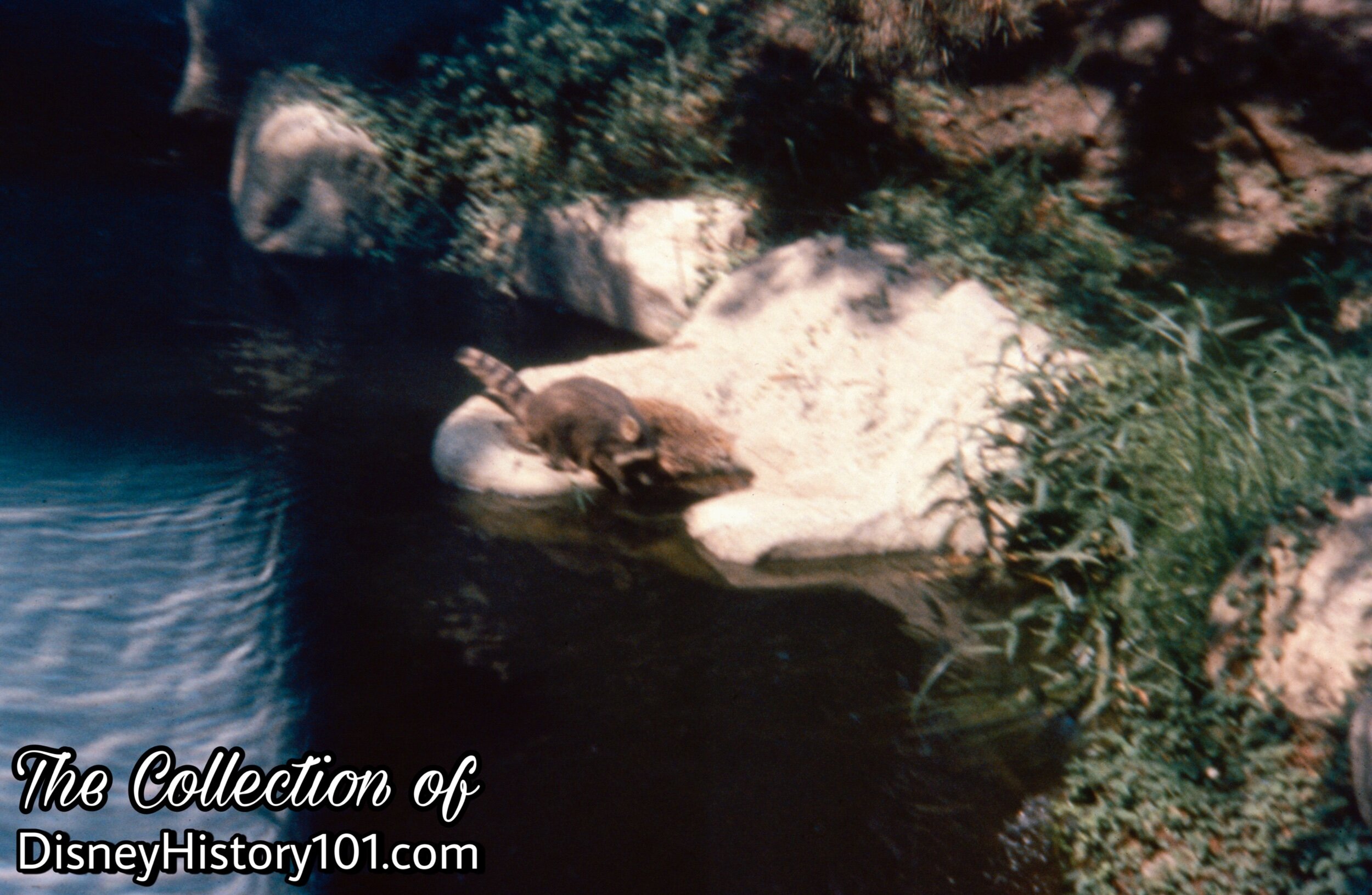
Many year later, people would populate a trail running through this area, clear from Frontierland to Fantasyland. For now, it’s home to this little rascal.
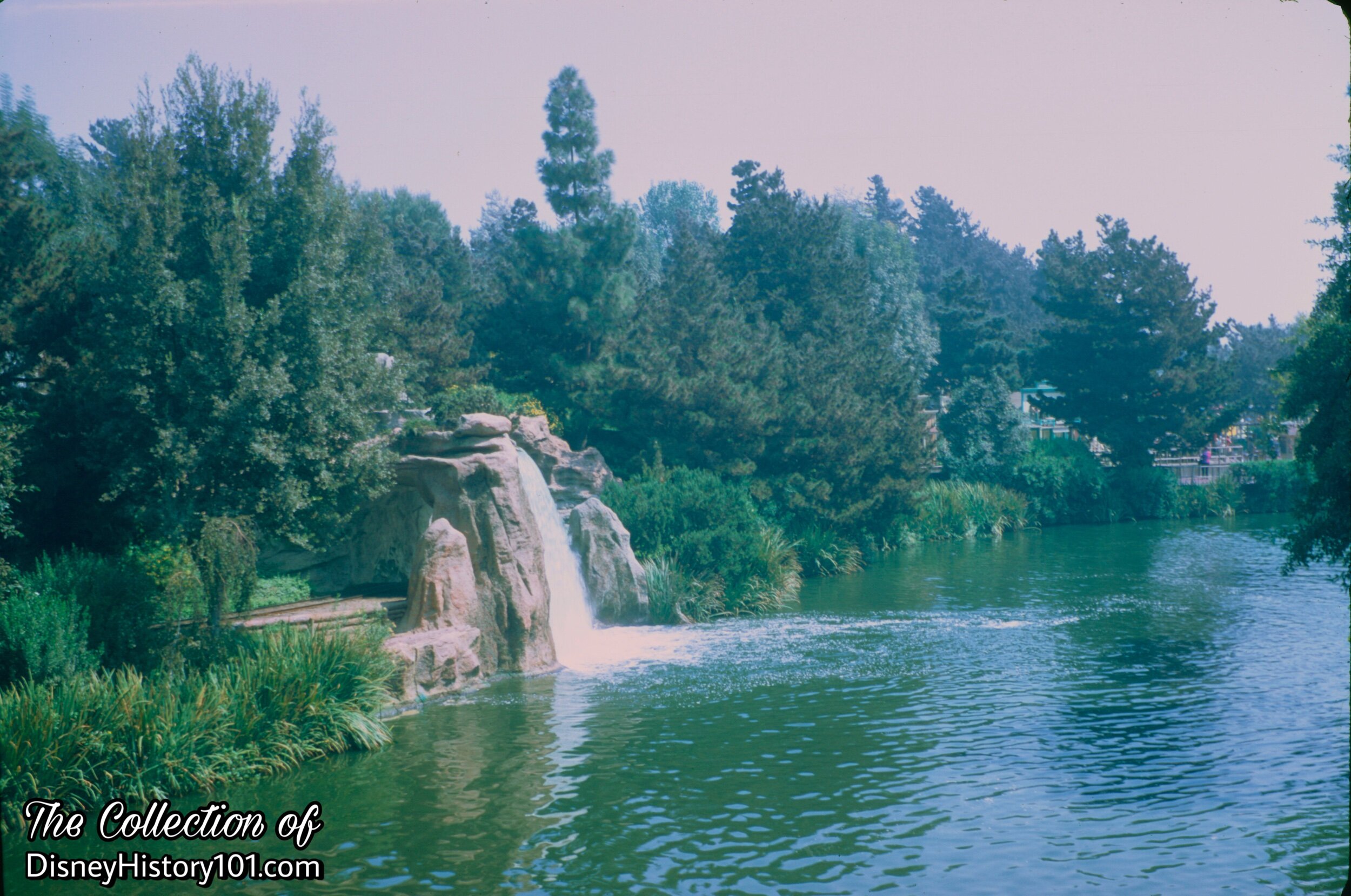
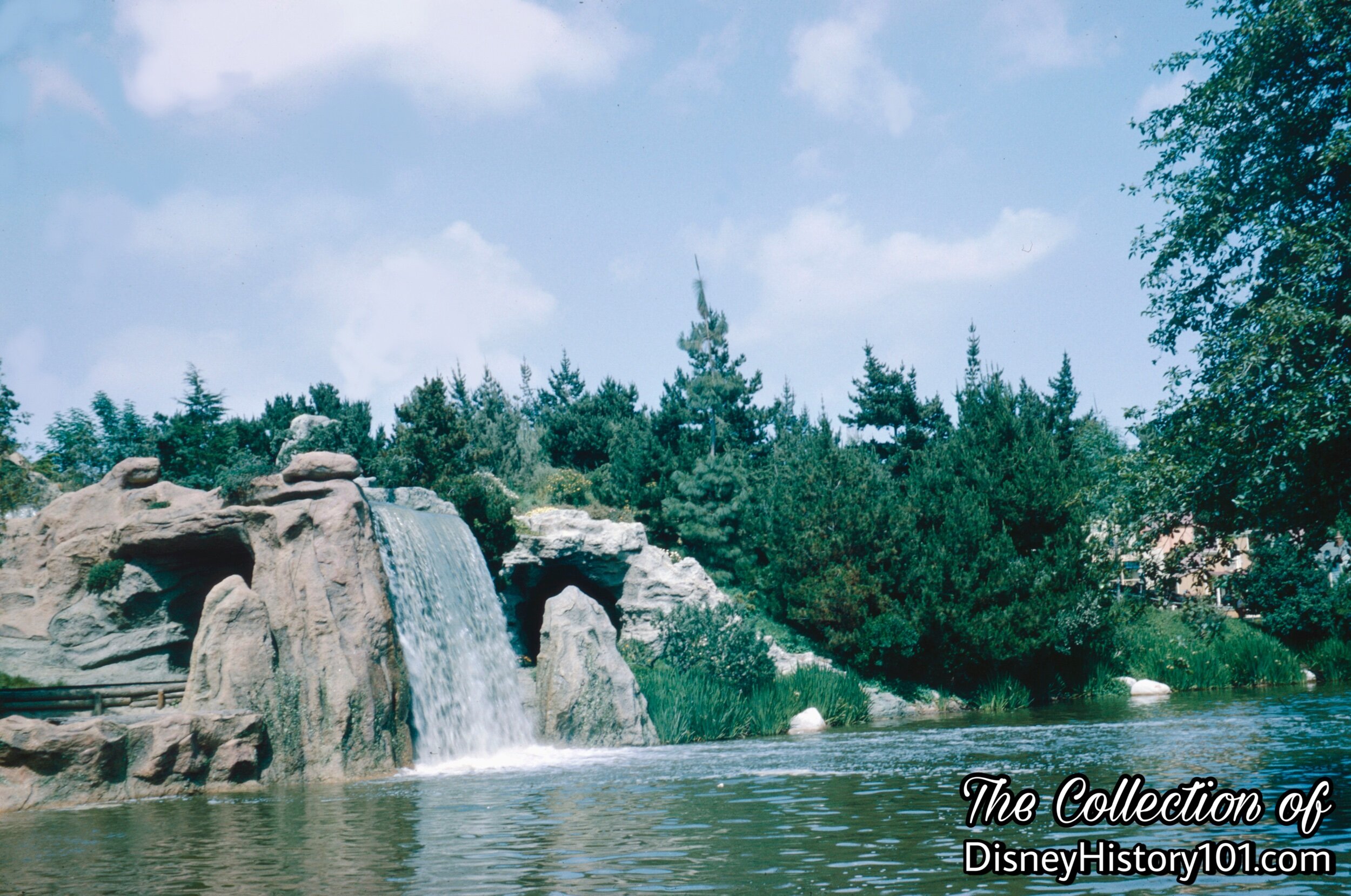
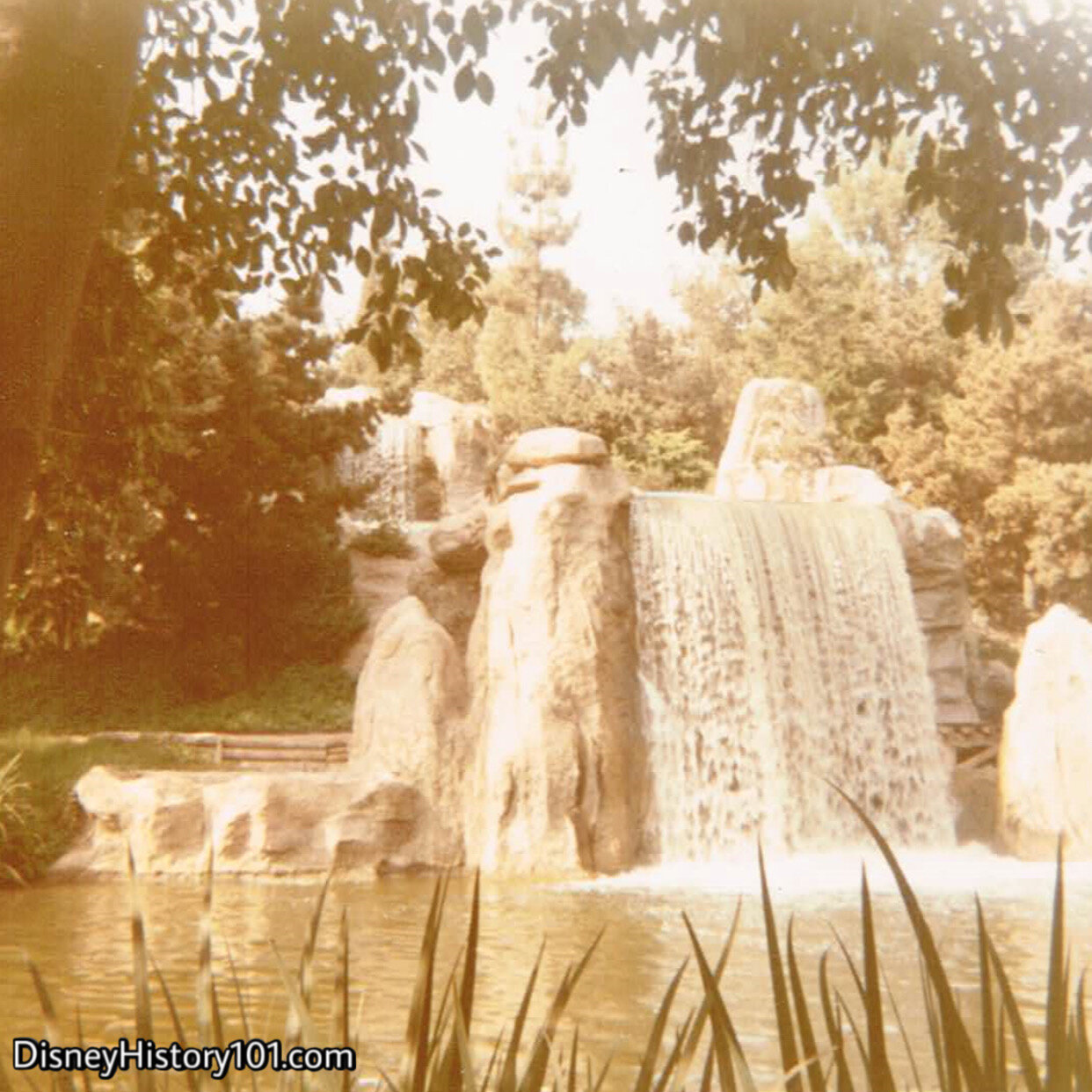
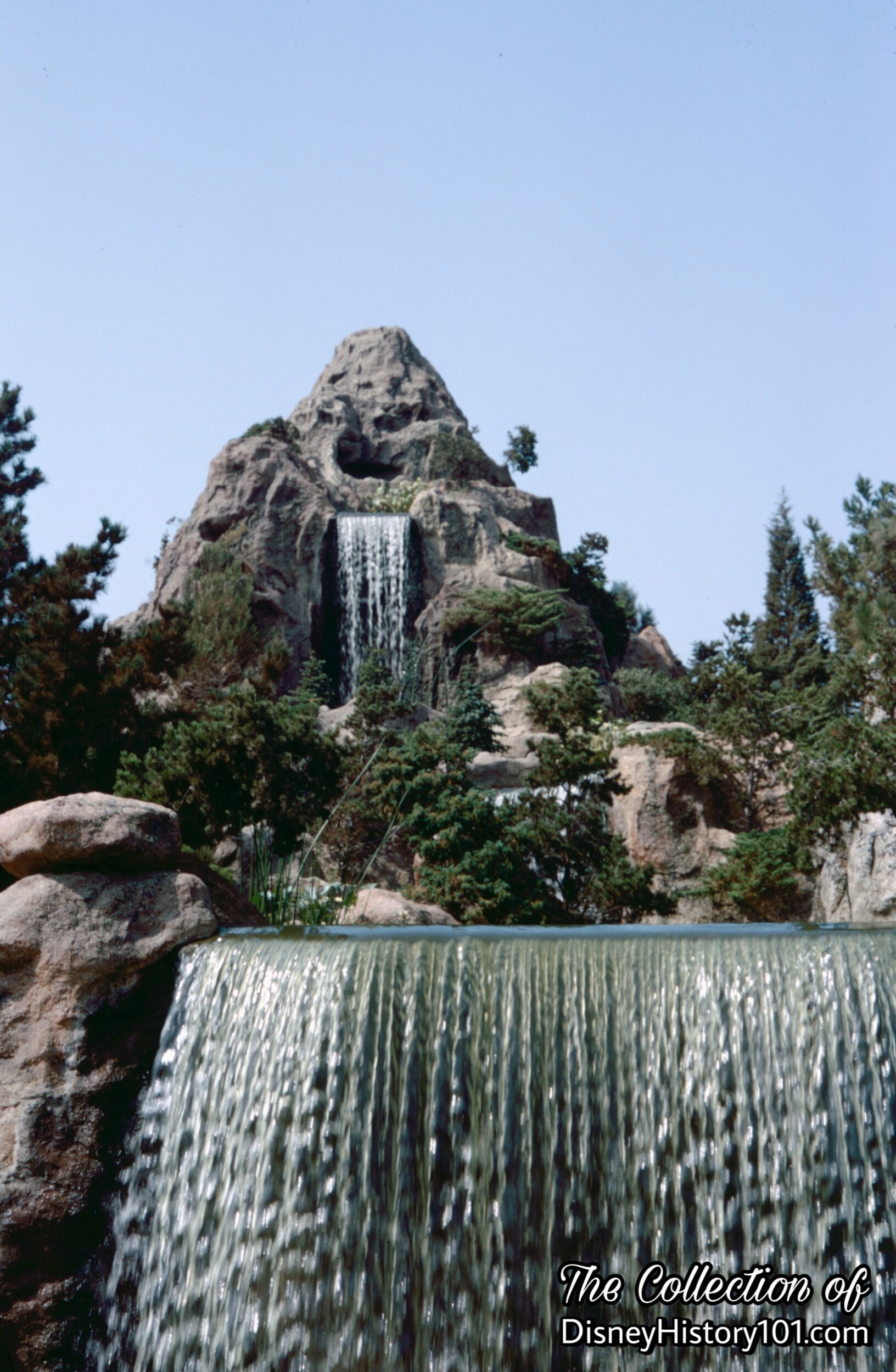
Most of the rocks and the mountains in Disneyland were products of the Staff Shop.
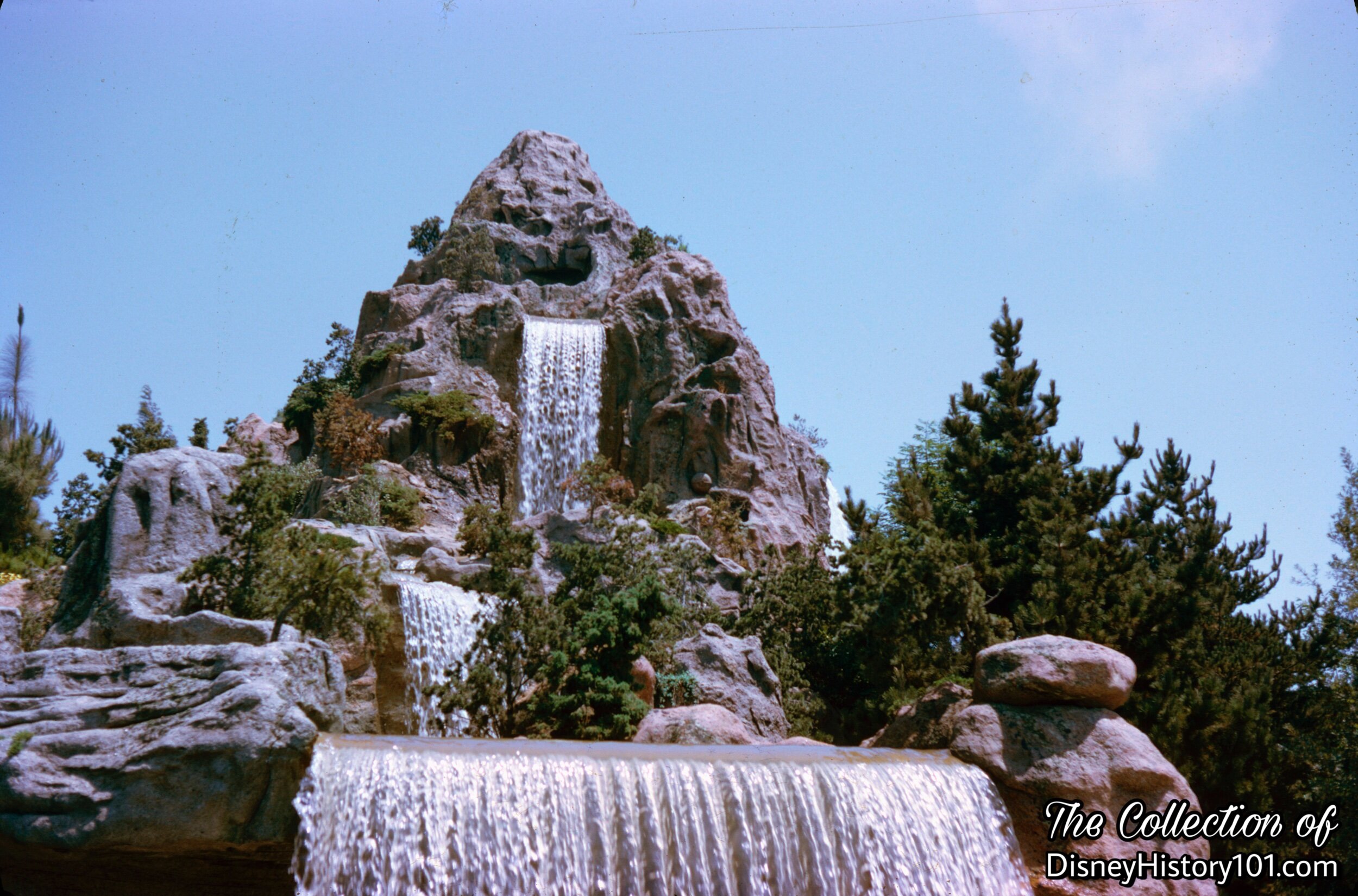
By 1974, the falls would recycle some of the 11 million gallons of water that comprise the Rivers of America.


The Tunnel from Beaver Valley lets out onto the Rivers of America, where we began to round Cascade Peak, with its roaring waterfalls!
“Now, beyond these hills lies Nature’s Wonderland. Yer apt to see a whole lot a wildlife, so keep a real sharp “hunter’s eye” .
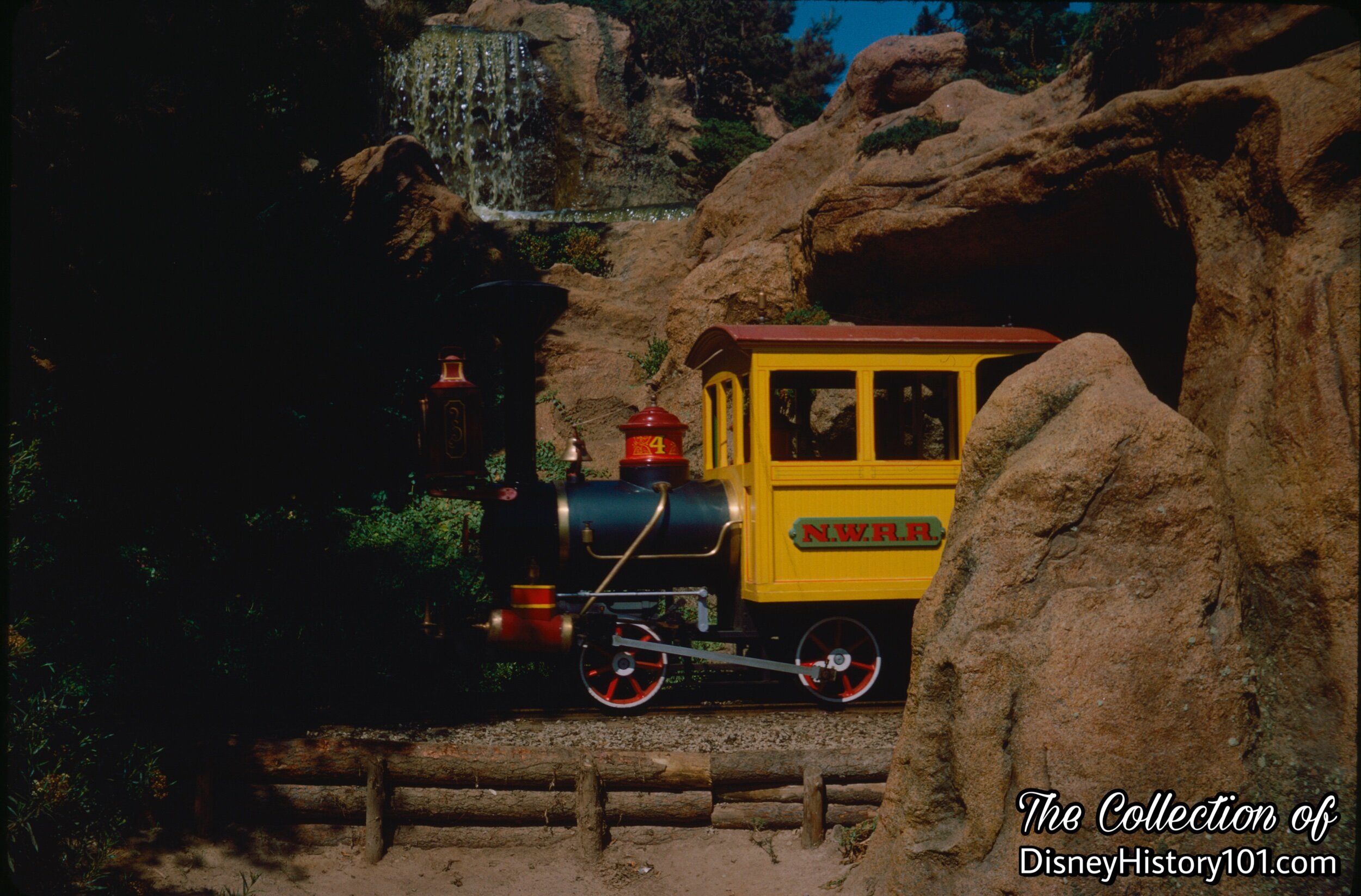
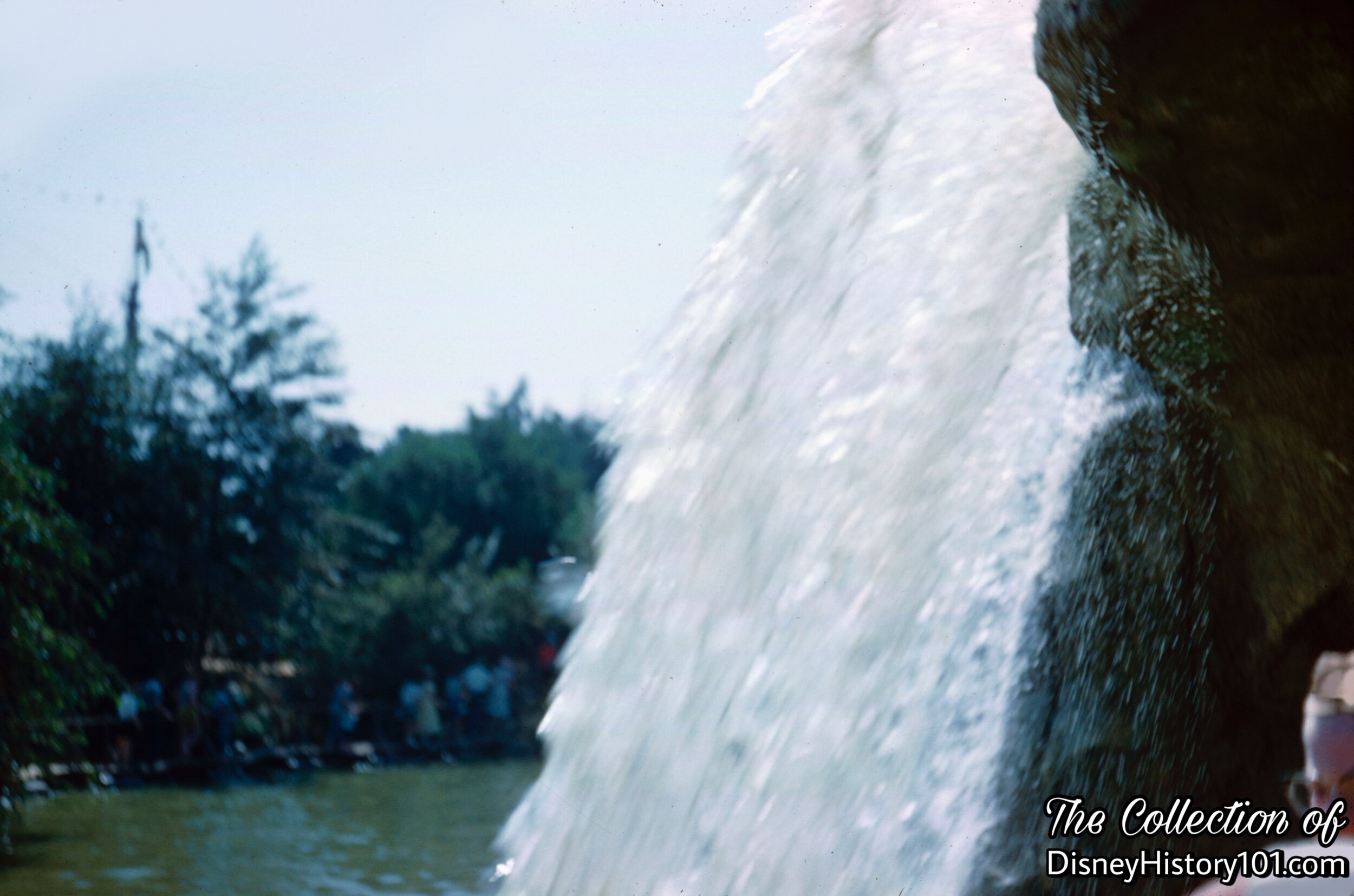
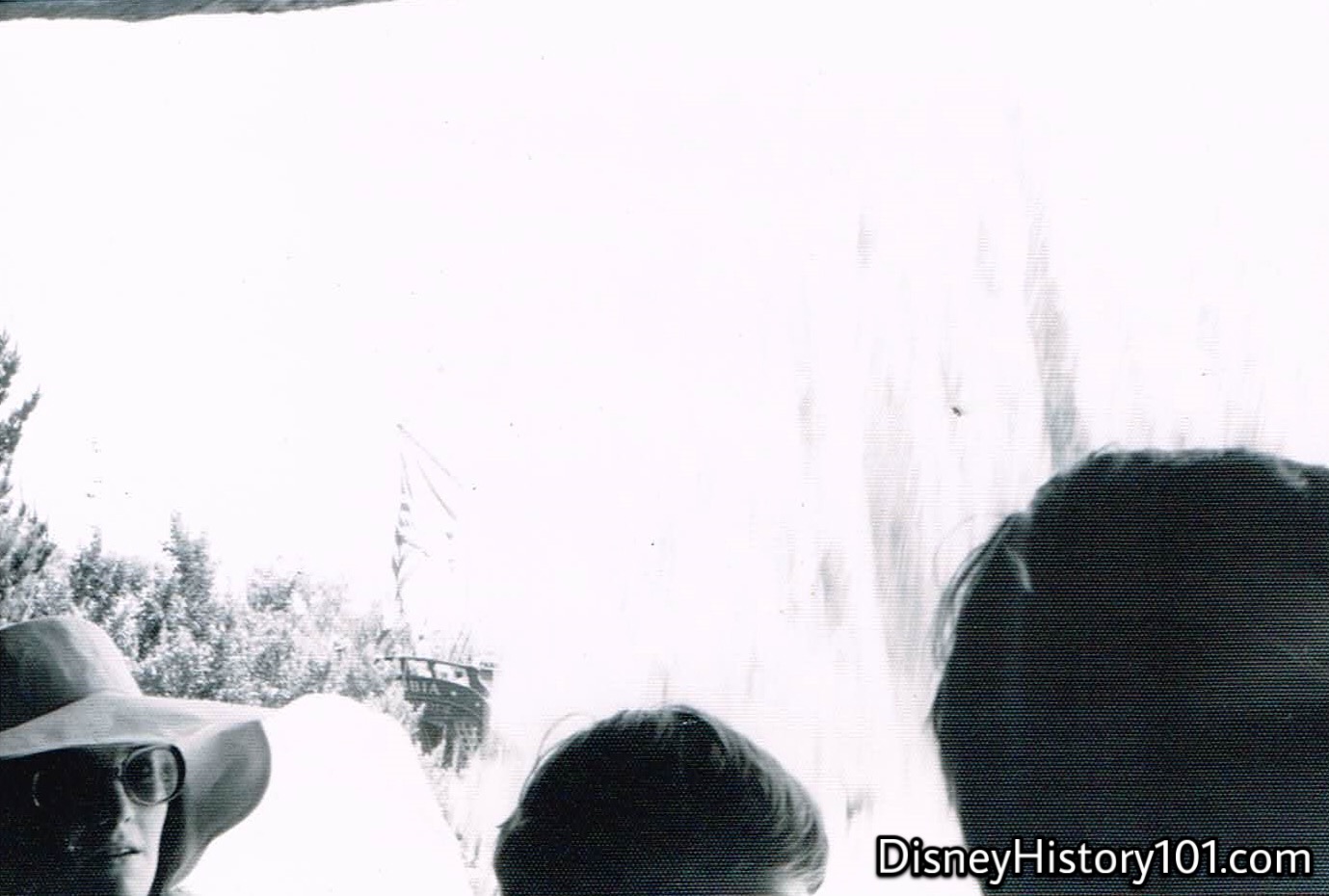

We’re heading towards Disneyland’s 75-foot-tall “second great mountain, ‘Cascade Peak’…easily recognized by the giant waterfalls that plummet from rocky ledges high on its granite slopes”, as described by Vacationland (Summer, 1960). “If ya never gone beneath a waterfall before, then get set cause we’re comin’ up on Big Thunder - the biggest falls in all these here parts!”
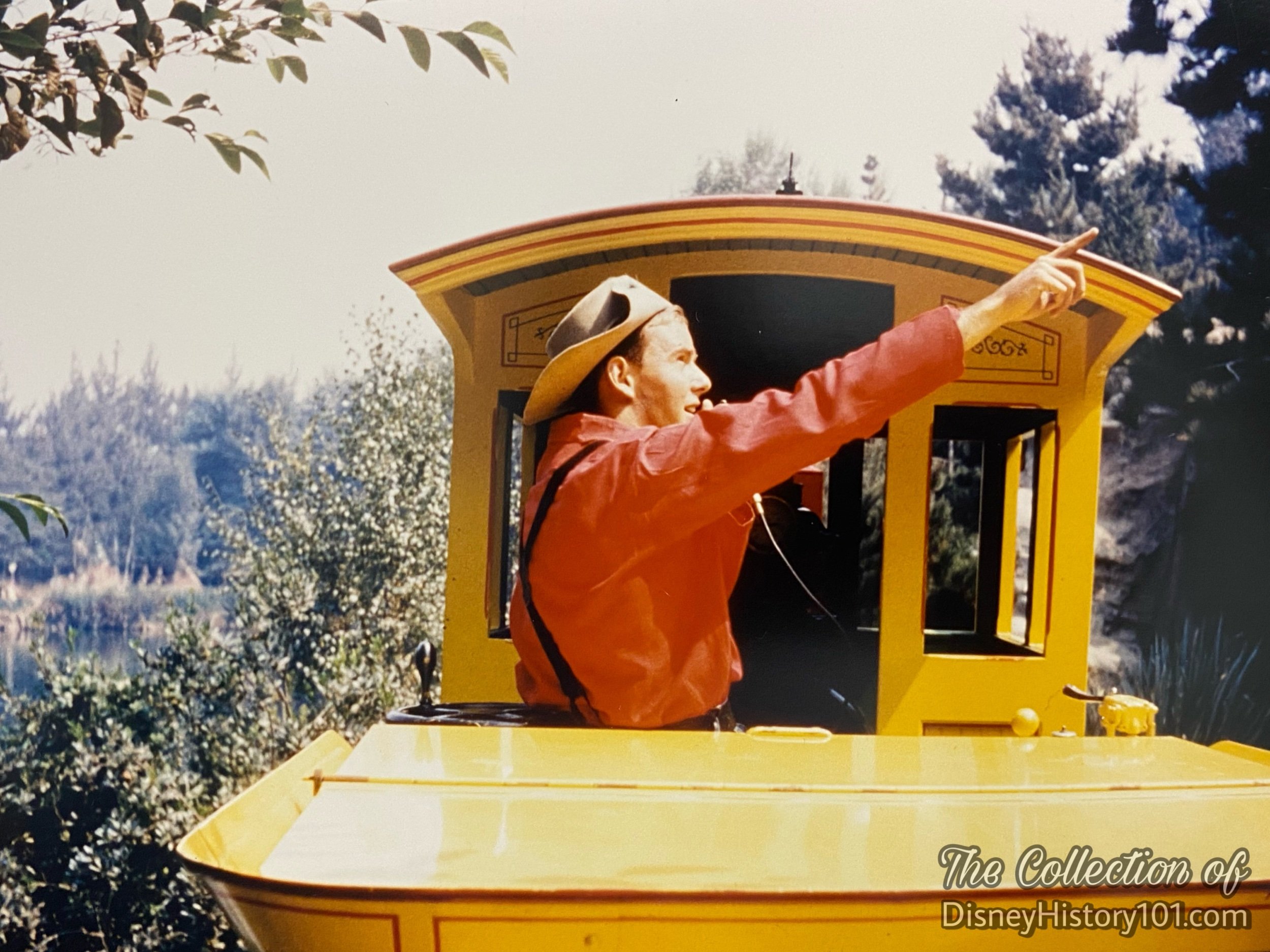
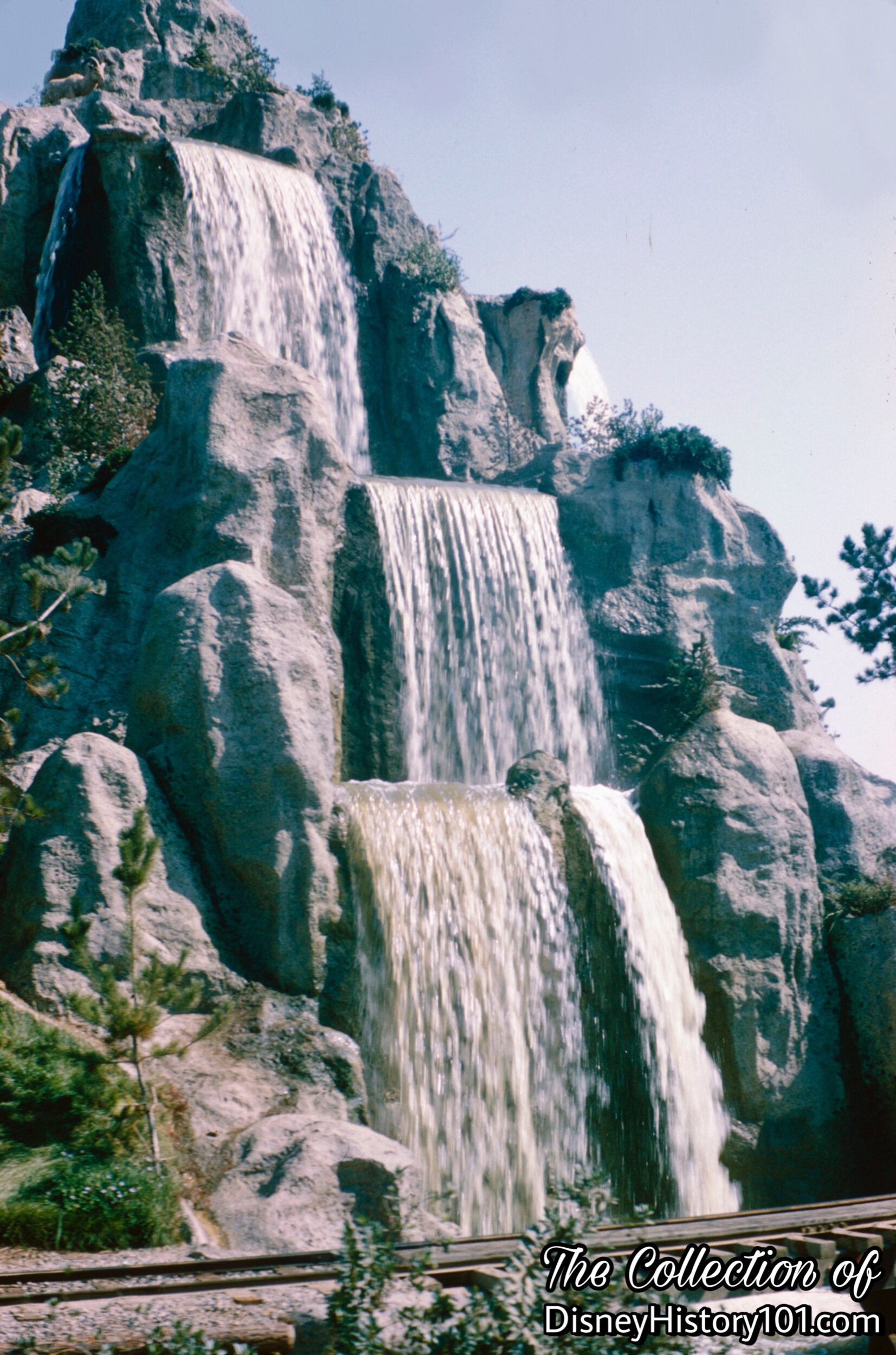
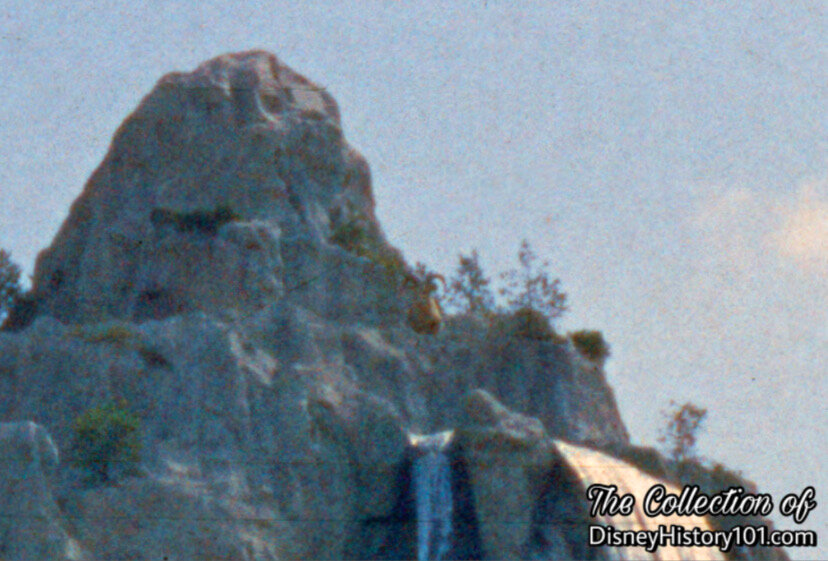

Keep a real sharp “hunters eye”, because you’re about to see one of the rarest Audio Animatronic creatures to ever set foot in Frontierland. We present the Mountain Goat near the top of the 75-foot RockWork of Cascade Mountain! The Mountain Goat had been spotted at the top of Cascade Peak, the Bounding Deer atop Rainbow Mountain over Beaver Valley, while the Bounding Big Horn Sheep were seen briefly along the Mule Train Trail in Beaver Valley). The Bounding Big Horn Sheep was even so prominently featured on the poster artwork for the Nature’s Wonderland Rail Road (which was modeled after the circa 1869 “Union Pacific Platte Valley Route Grand Opening” poster), which can be seen on the “Disneyland ‘60” handbills given to guests at the Main Gate! According to Bob Gurr’s True-Life tale, their bounding would spook the mule trains, so the Bounding Bighorn Sheep (atop Cascade Mountain), the three Bounding Deer (a buck, doe and fawn) at the top of Rainbow Mountain, as well as Mountain Goats would silently disappear within a month of the start of Mine Trains Thru Nature’s Wonderland. Similar precautions were taken by the Mine Train operators to not spook the mules with the bells or whistles.
“MATT LEIKER REALLY REMEMBERS SEEING SOMETHING ATOP CASCADE PEAK, c. 1990”
“Finally!!!! Something I have wondered about for over twenty years gets answered!!! When I was a trainer on Big Thunder Mountain Railroad in the early 90s I used to hop the fence with my trainees and take ‘em out to explore the mule trails. I would also take ‘em inside Cascade Peak and we’d climb the ladder and exit outside the top for the view. As soon as we would emerge there was a rusted base, and parts of a mechanical contraption that you can tell once held some sort of object that would move or rock back and forth. Vintage Disneyland photos and history are everywhere now but back in the pre-internet days of 1994 there was absolutely no place to find out what was once there. I sometimes marvel at that…how even while working at the park, there were really no sources for quality park history or people around who knew (or even cared) what much of the old stuff was. The best you could ever find were framed photos of old attractions adorning the walls of a scheduling office but even those were usually the same tired staged photos that were used and reused in the souvenir guide books through the years.
Anyway…I continued to wonder about this for years, always studying every old photo or postcard of the peak, looking for a sign of some animatronic, balancing rock or special effect that once existed up there. Over two decades passed with no luck but I remained absolutely sure that some show element used to exist up there. Finally, today the mystery question gets answered and confirmed!!!
Thank you.”
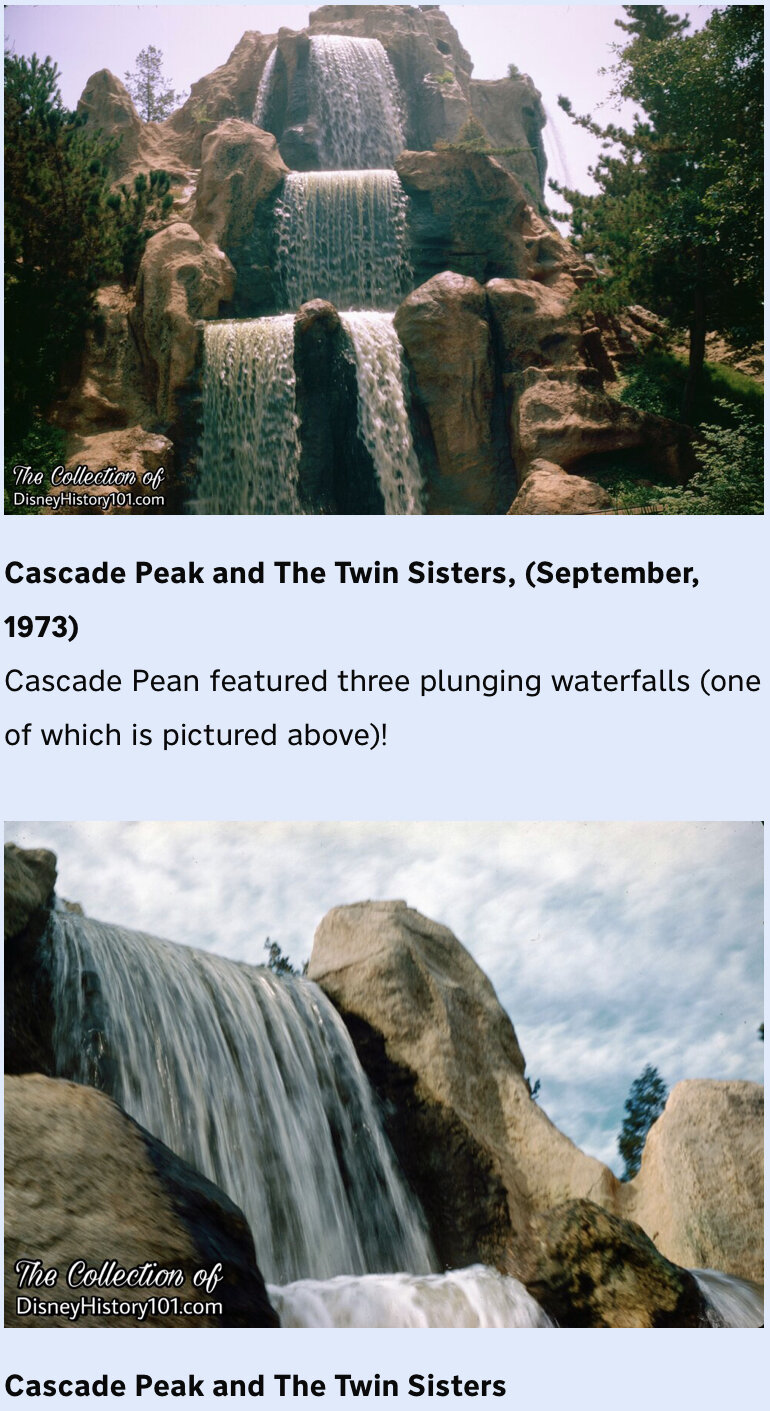
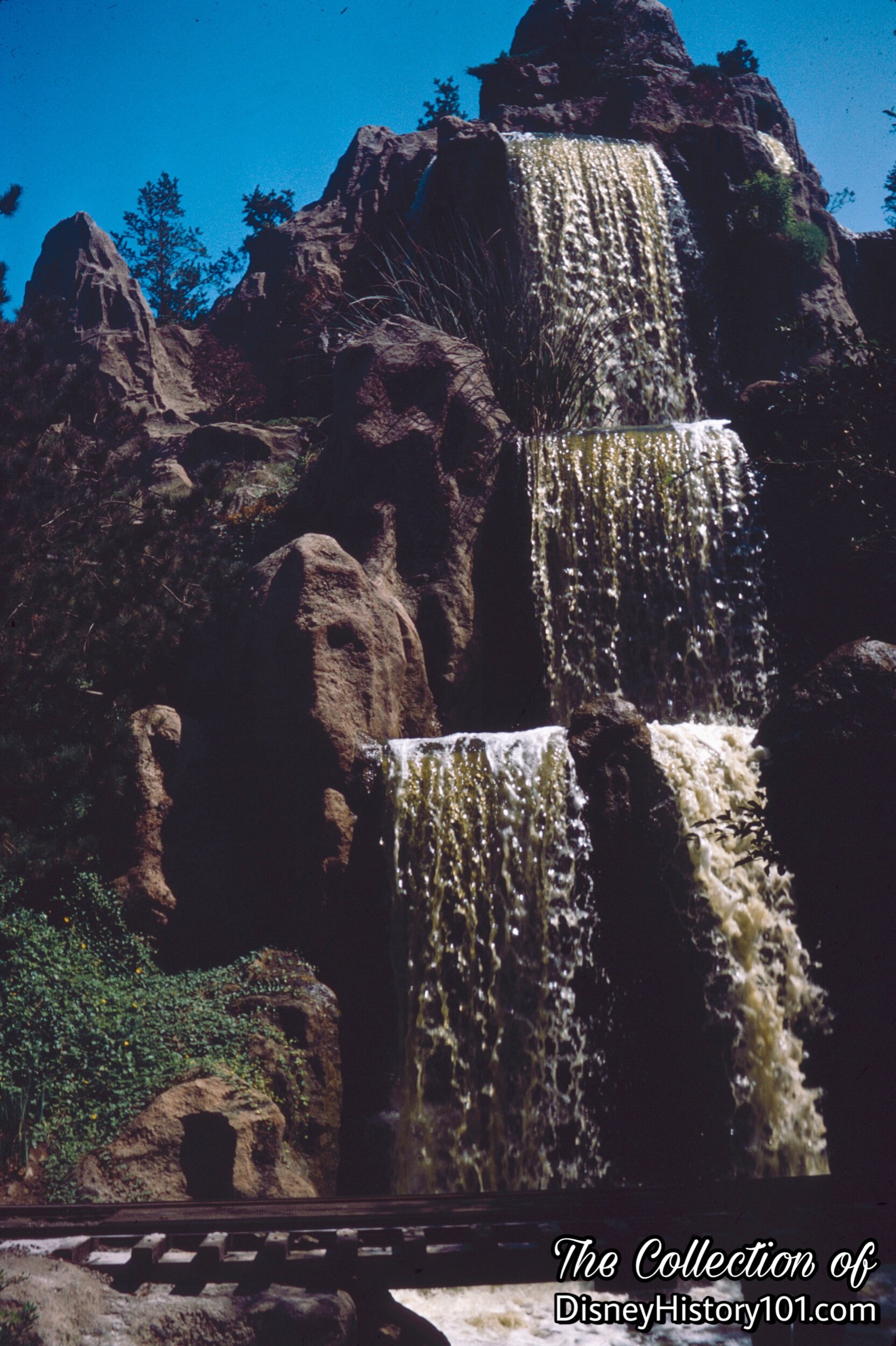
This “natural wonder” was actually a hollow seven story frame of wood and steel. Inside Cascade Mountain, are three pumps (totaling 510 horsepower) feeding 91 tons of water into pools and into the 11-million-gallon Rivers of America! You may be wonderin’ where all that water comes from, as it seems to spill forth endlessly. Well,… Disneyland actually has several wells on property. Coupled with a supply of city water, (some of which comes as far away as Parker Dam), this truly wonderful and “natural” scene is effected!
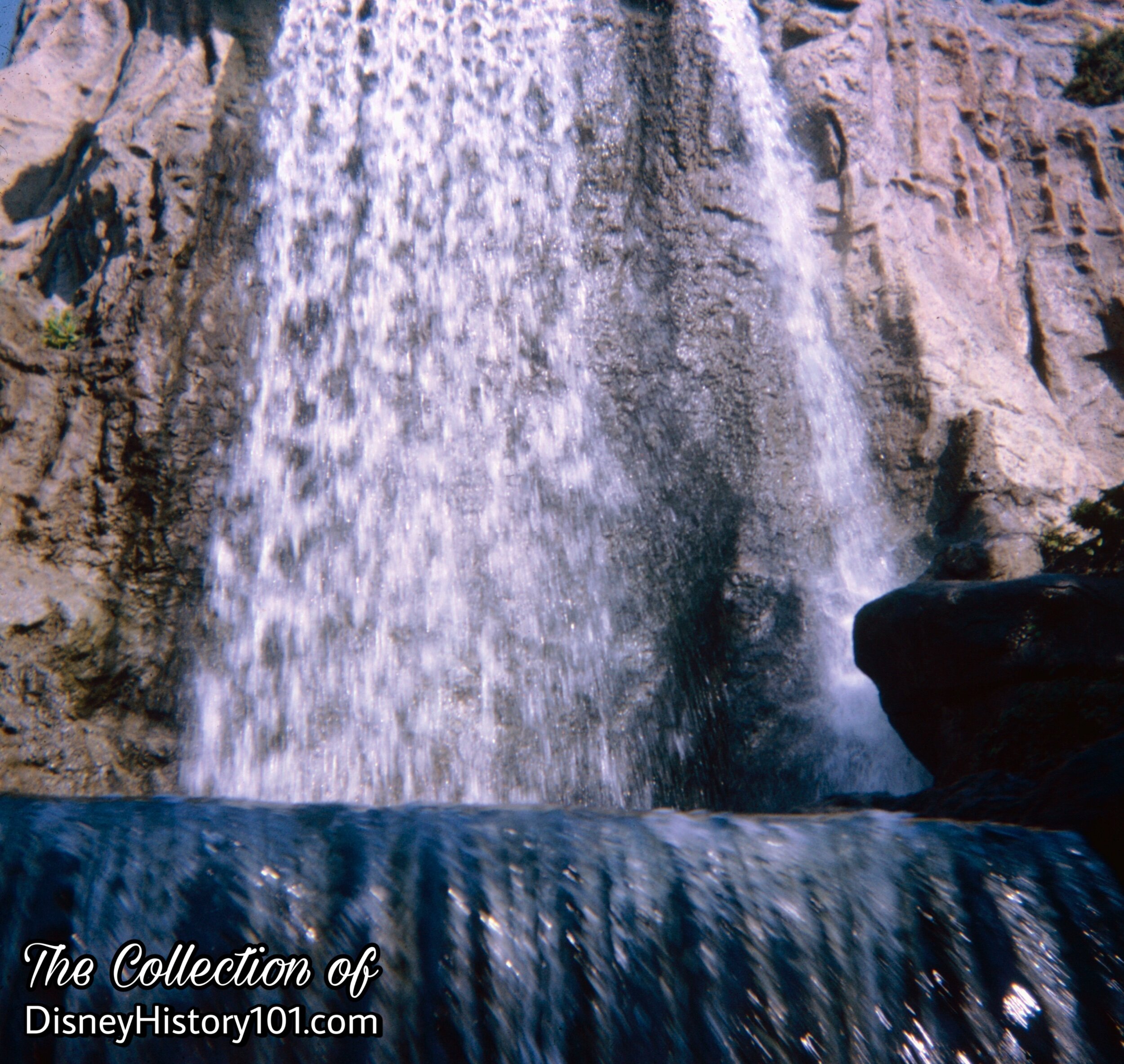
“Them other two falls - they call The Twin Sisters. I recon that’s because they’re always babblin’!” The sheer sound of the rushing water masks the song of robins and jays in the nearby tree branches.
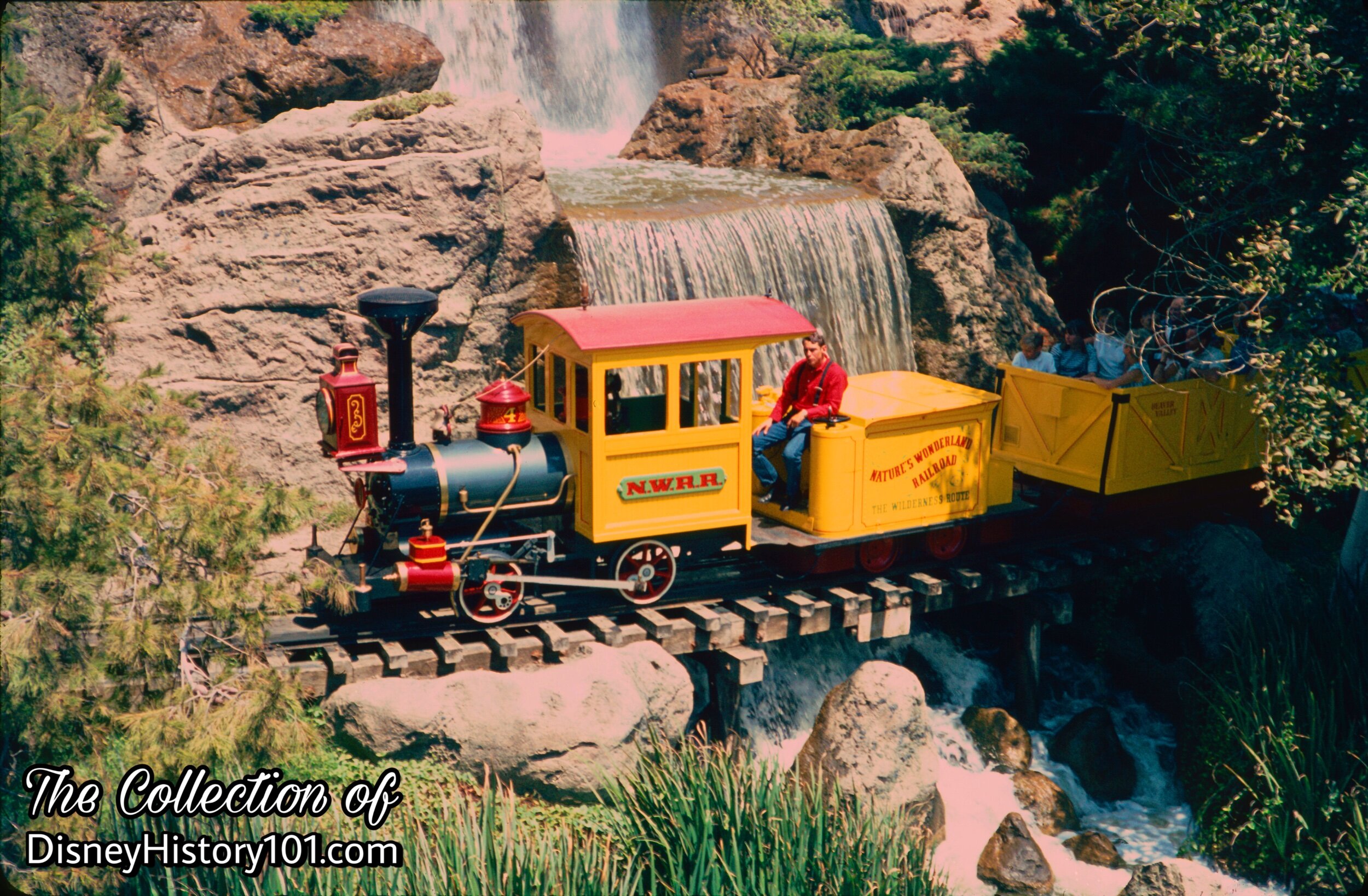
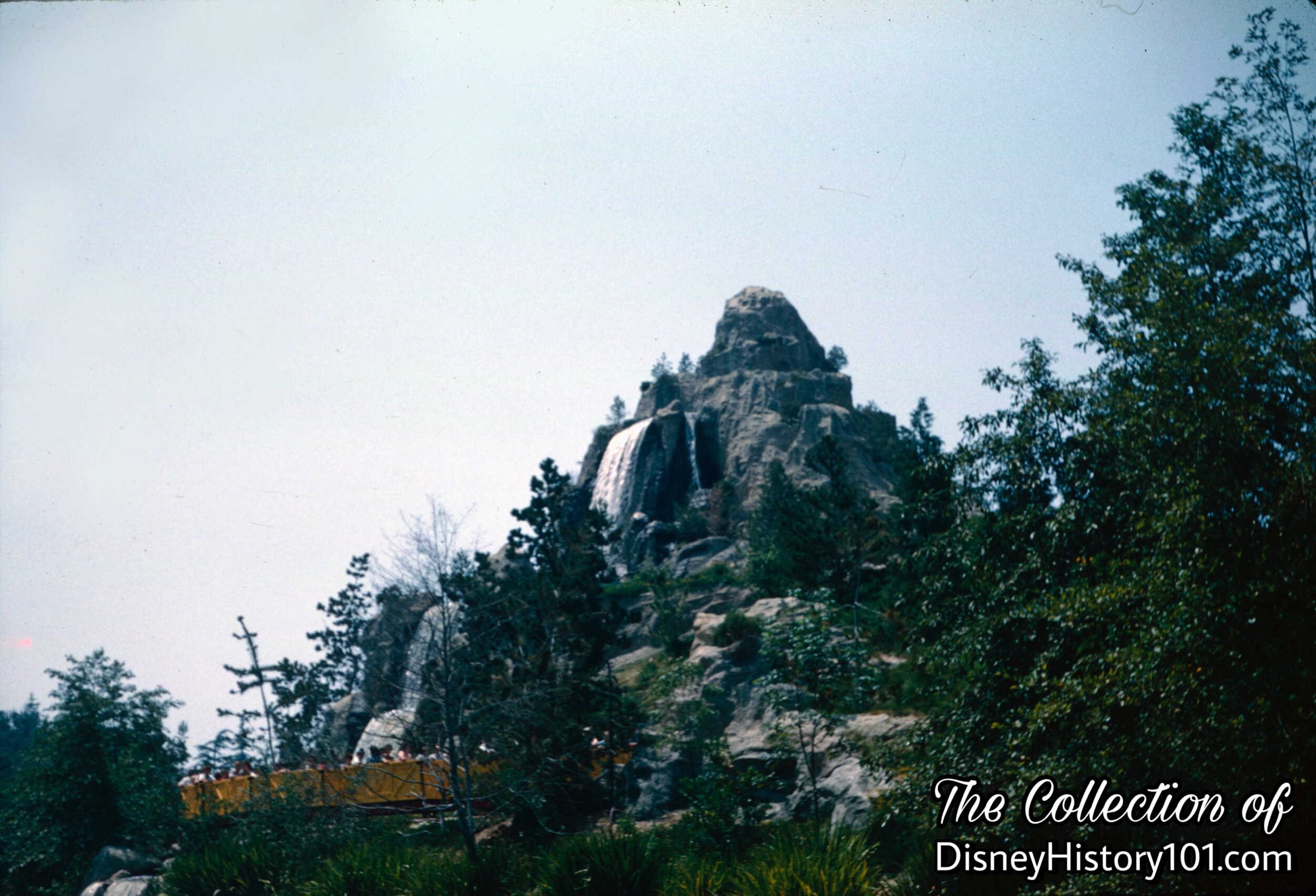
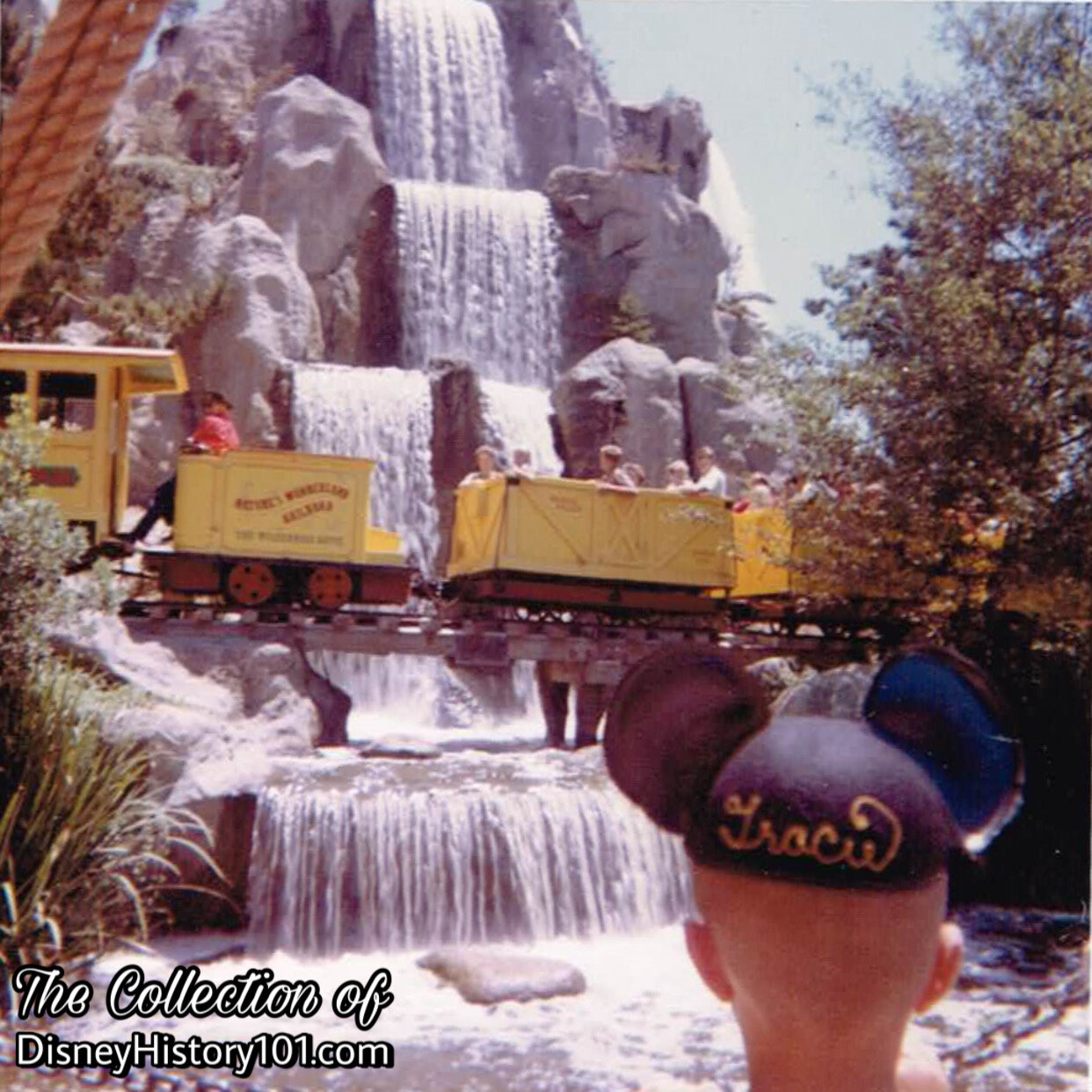
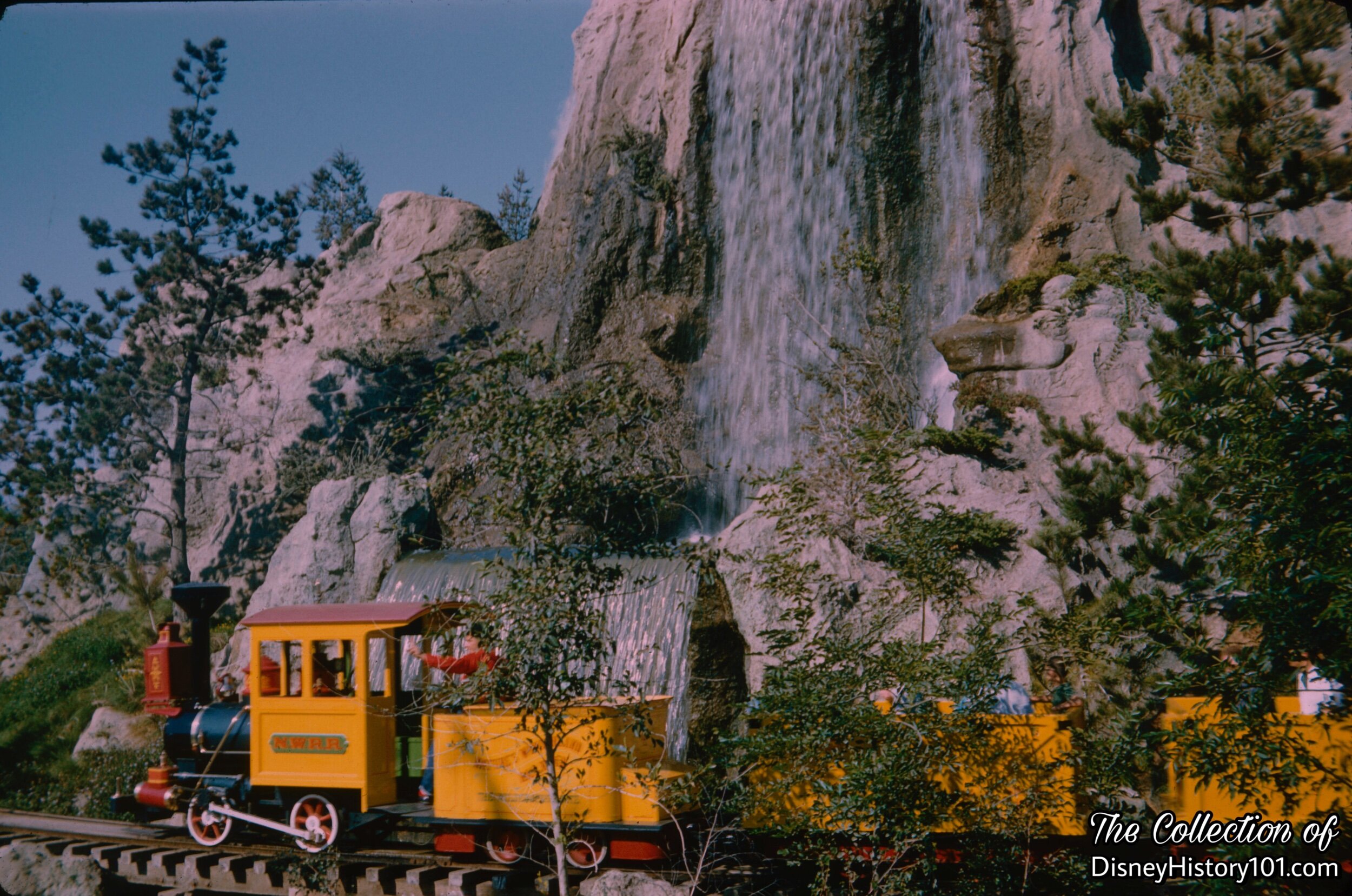
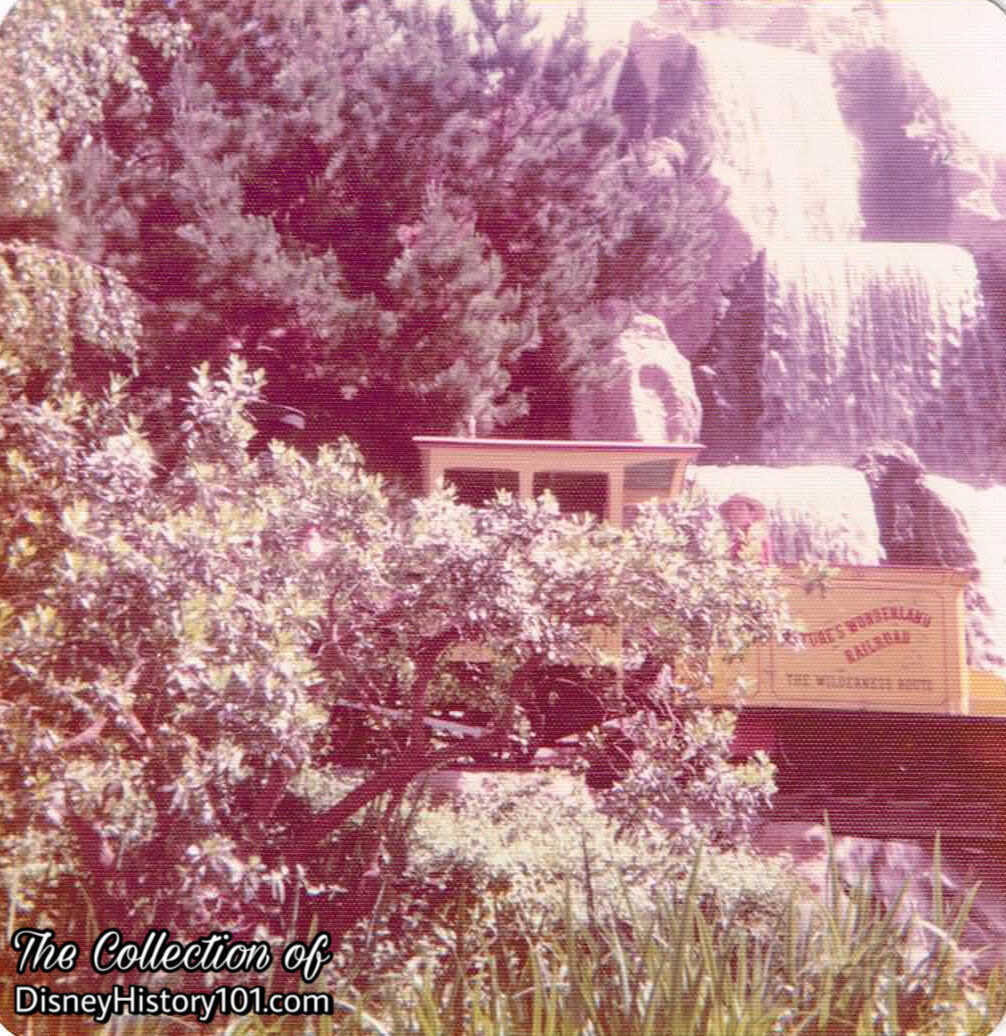
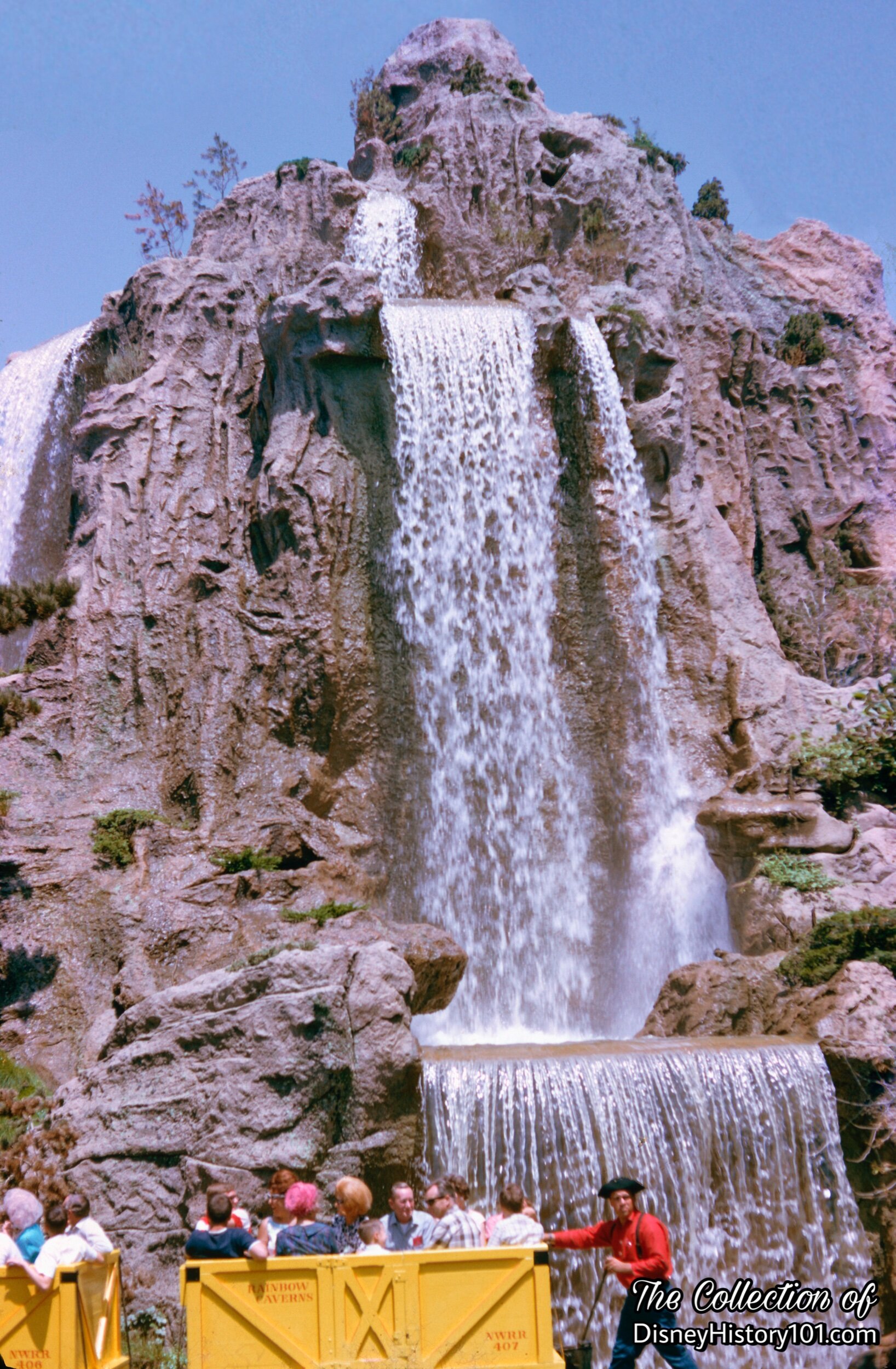
It doesn’t look as if we’ve had a “breakdown”, so there’s no need to call Disneyland Operations or the Disneyland Maintenance Department (though this may ultimately end up in our Daily Maintenance Report). The Brakeman generally sits in the last car in case we need to bring the train to a halt.
Milo Rainey recalled standing on a little porch on the last car and giving a live spiel.
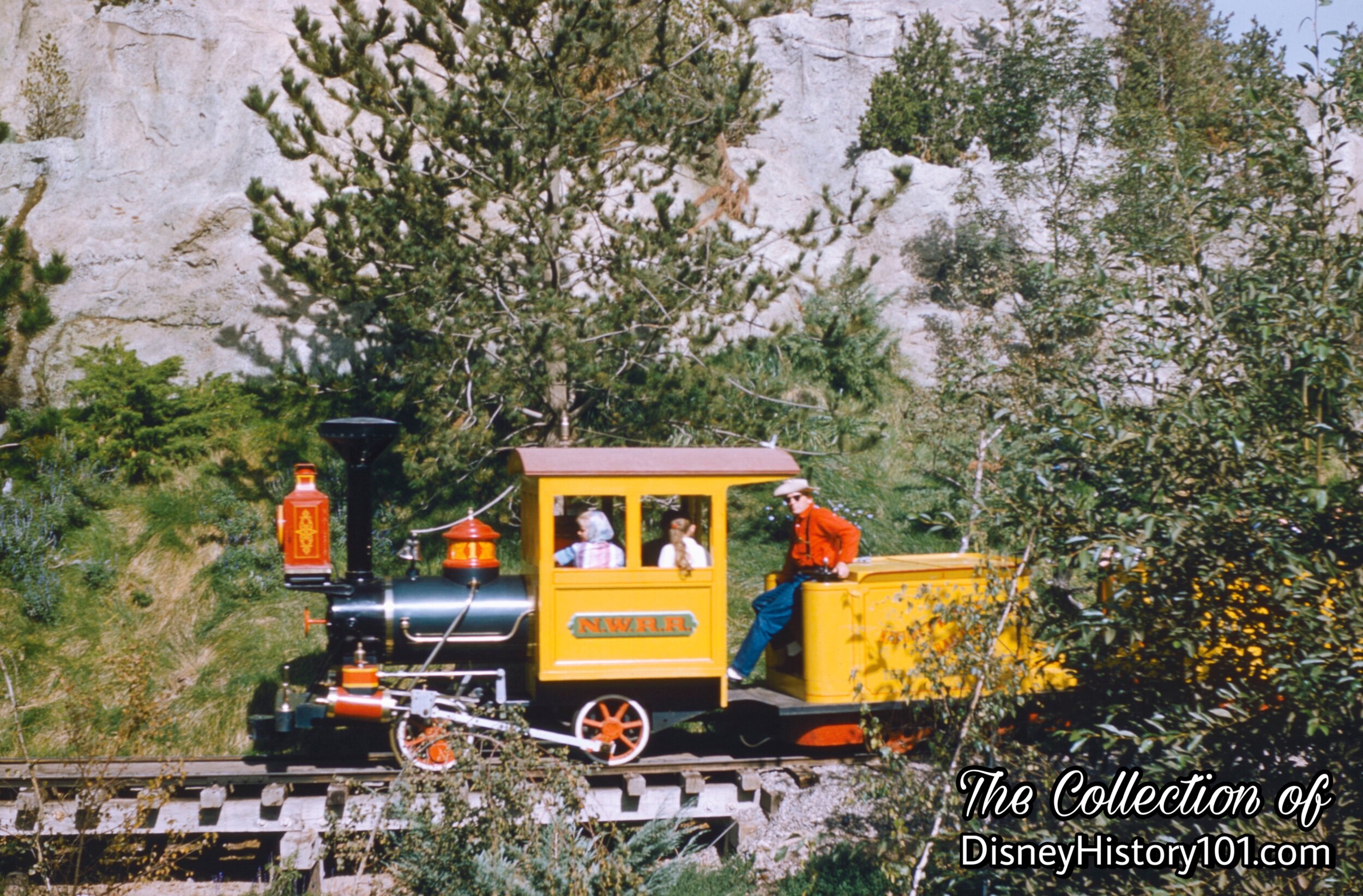
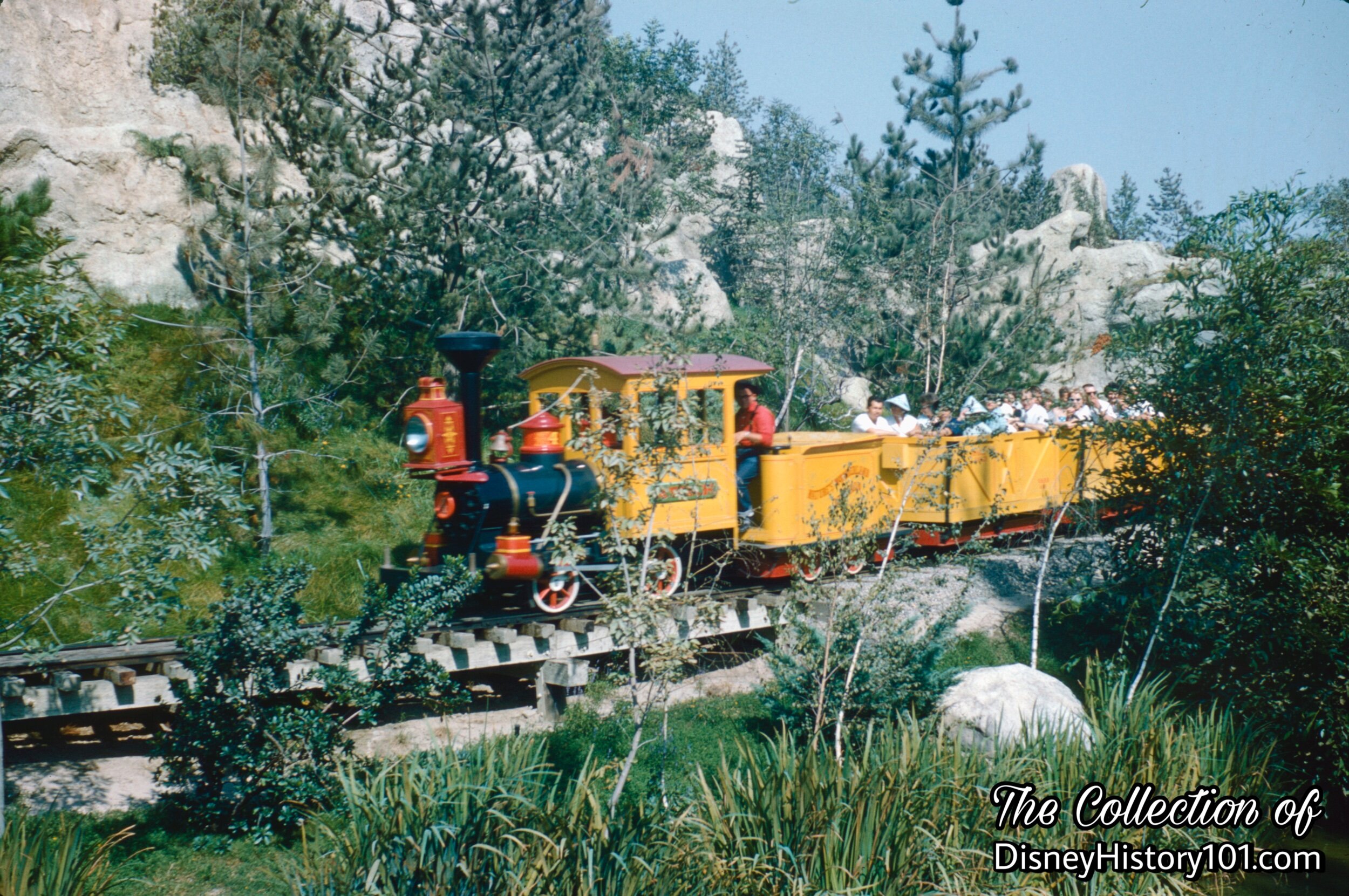
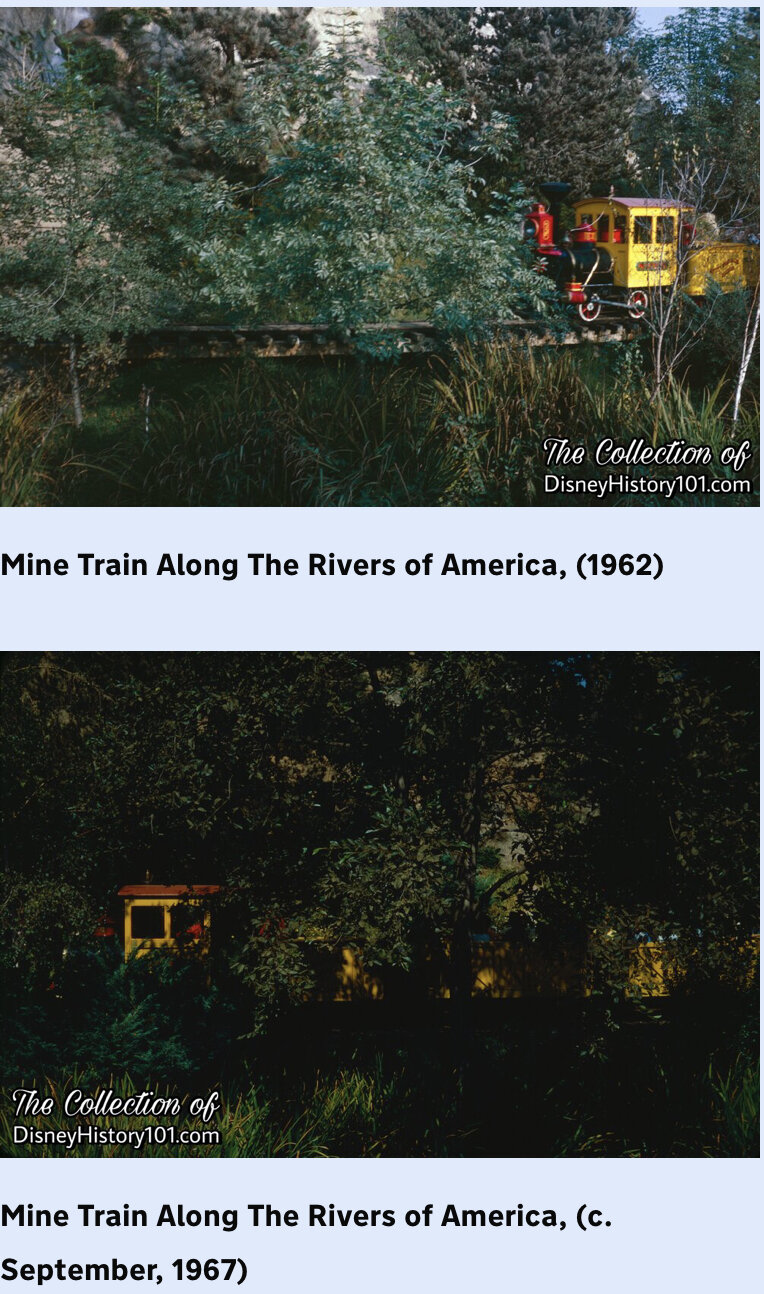
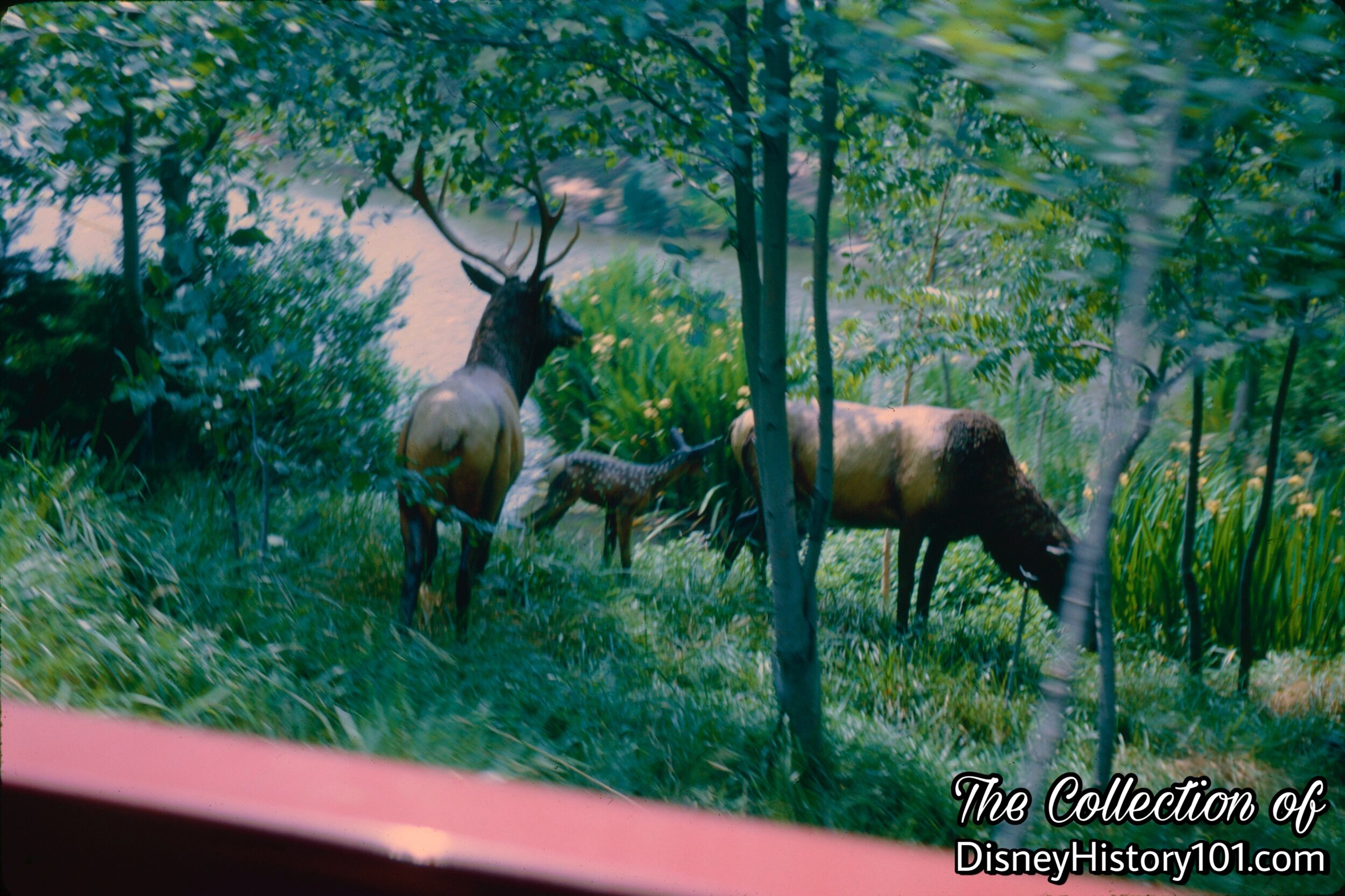
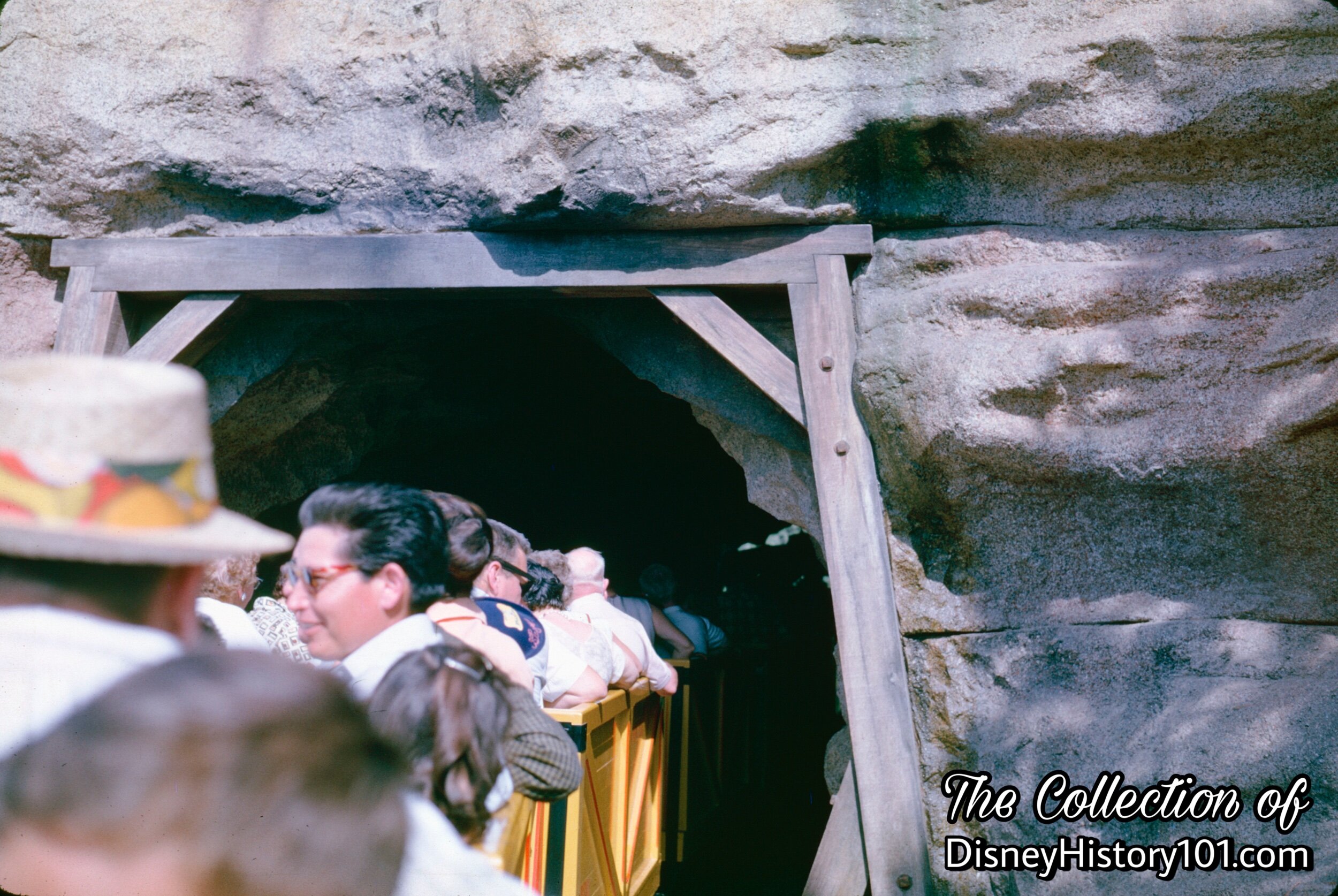
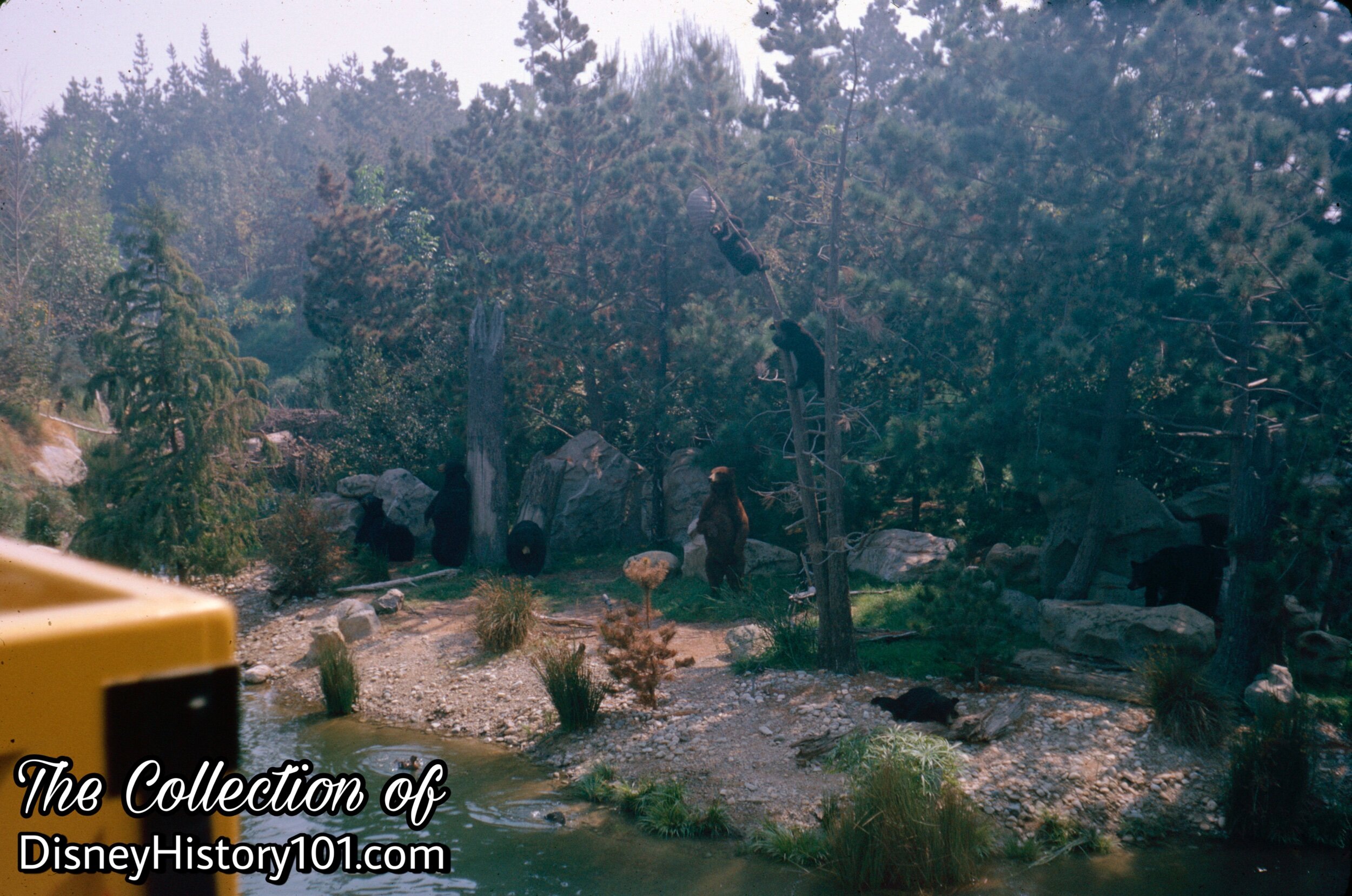
“Y’know bears is one of the most playful animals there is…lazy too. All they want to do is lay around and scratch, fish, an’ swim. That is, when they ain’t sleepin’.” Here, twelve Bears and cubs swim, fish, eat, and relax around Bear Country! Just one question - which one is “King of the Grizzlies”?
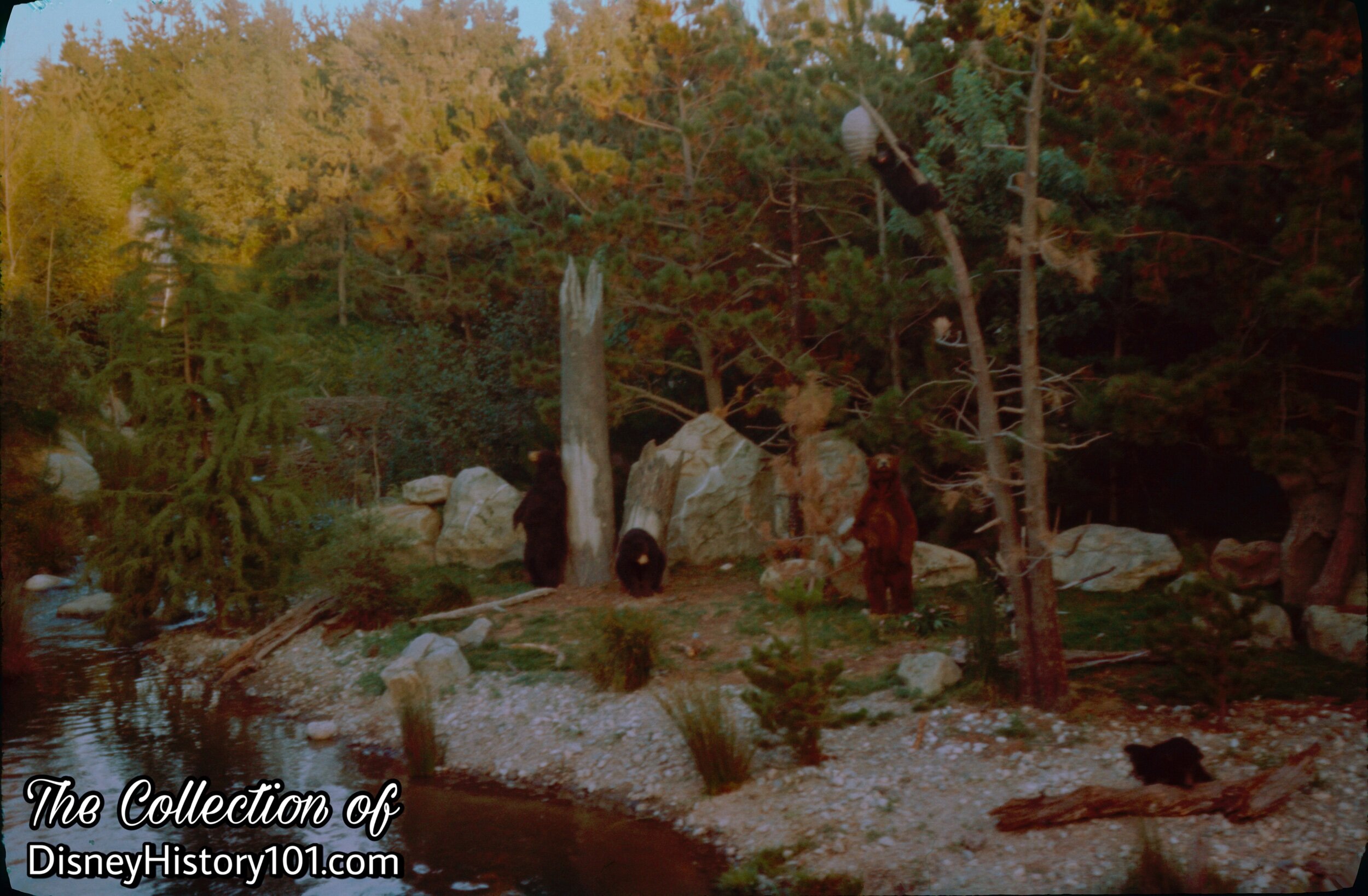
“We’re comin’ into Bear Country now folks, and while we’re crossin’ the ol’ tressle ya got ta sit real still. No tellin’ how long he’s gonna last.” Many of these “natural” vignettes were designed by Marc Davis (the same designer behind many of the Pirates of the Caribbean’s show scenes)!
If you look into the hills, you’ll notice just some of Nature’s Wonderland’s 156 different types of trees and other flora. Many of these were imported to Disneyland and placed under the direction of Landscaping employees Evans and Reeves.

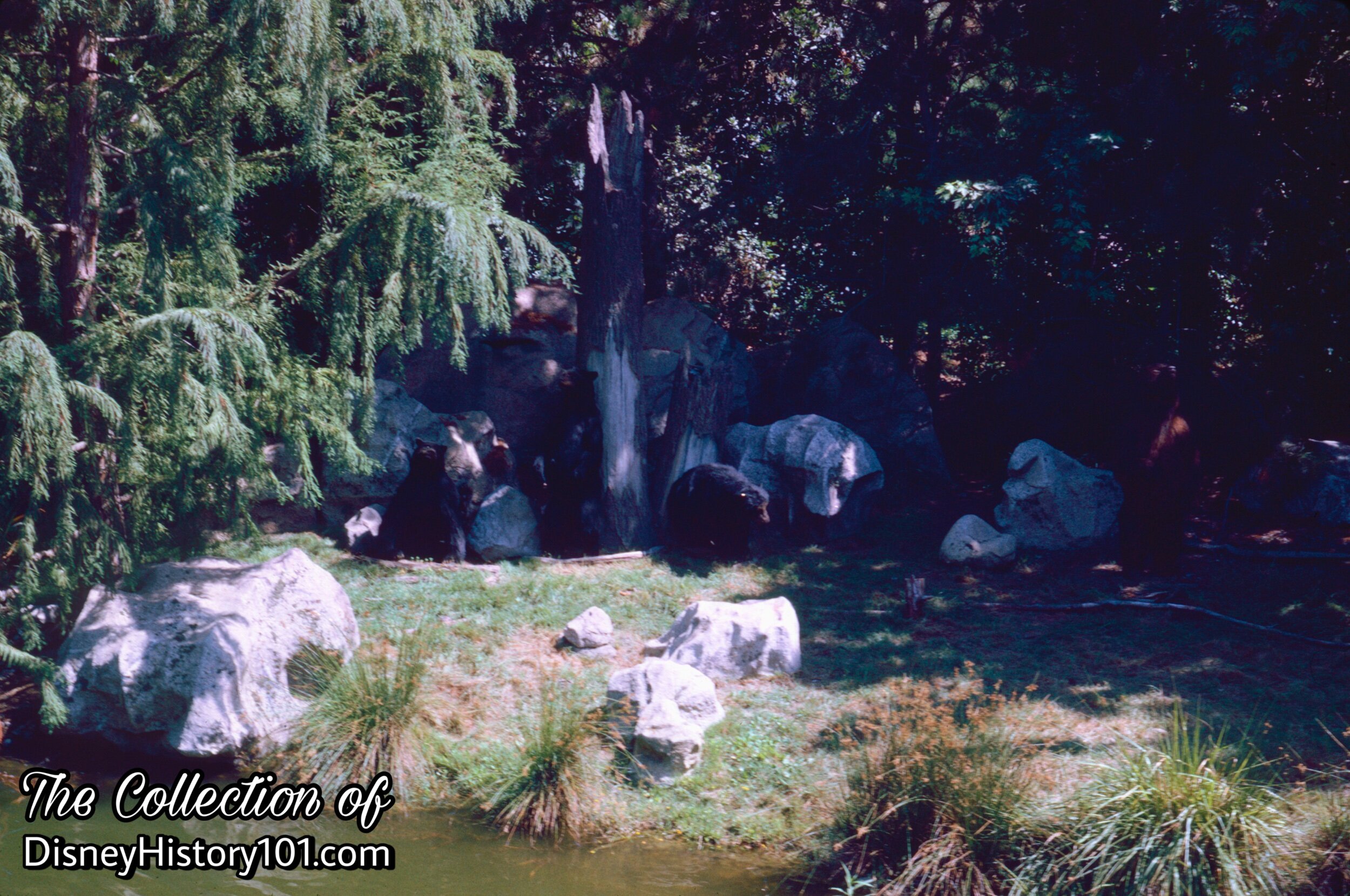
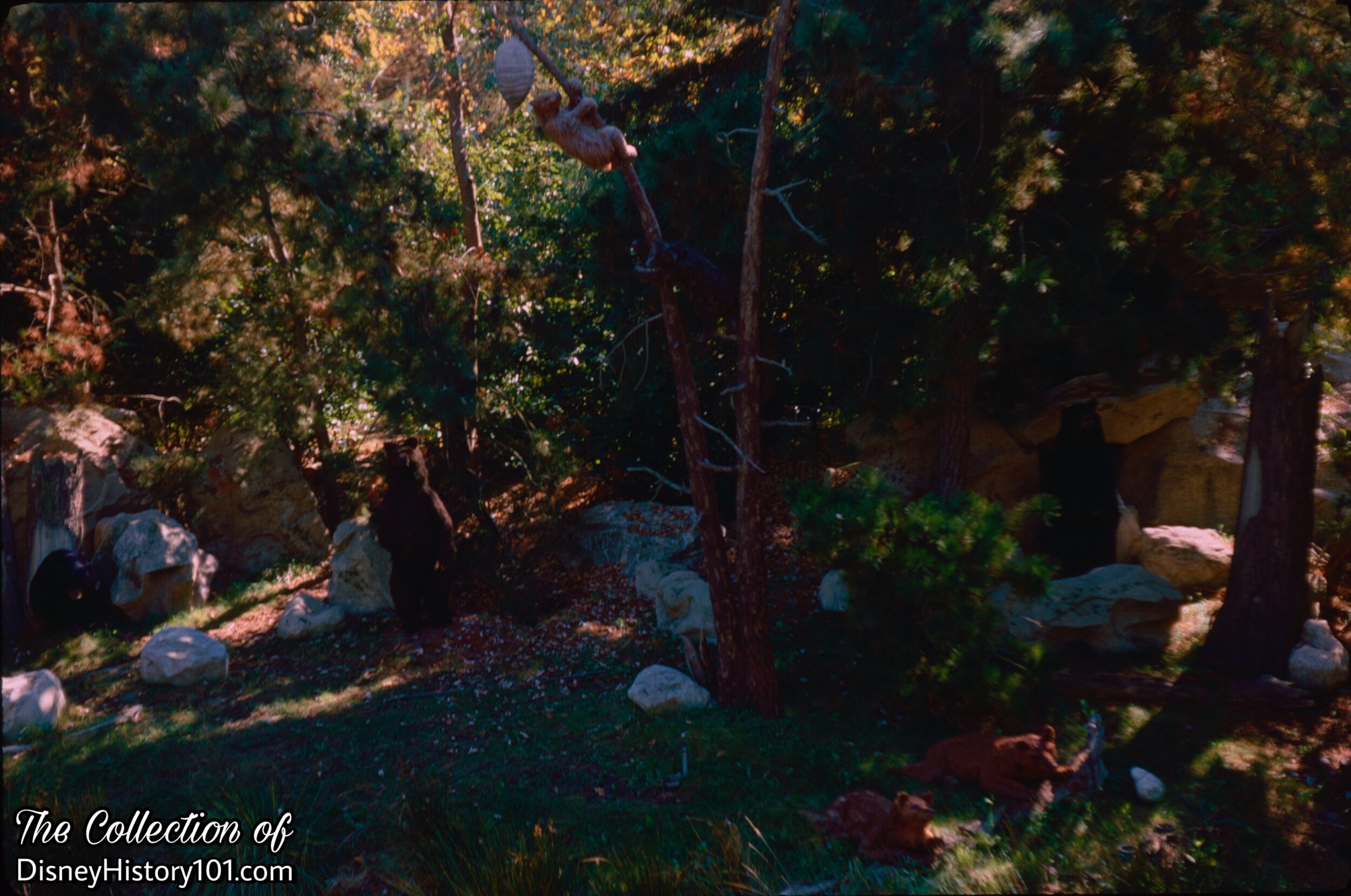
You may notice a number of rocks across the landscape, along your tour today. Many of those rocks were not manufactured at WED, but are “true-life” rocks, carefully selected, imported, and “installed under the direction of a WED Enterprises Art Director”.

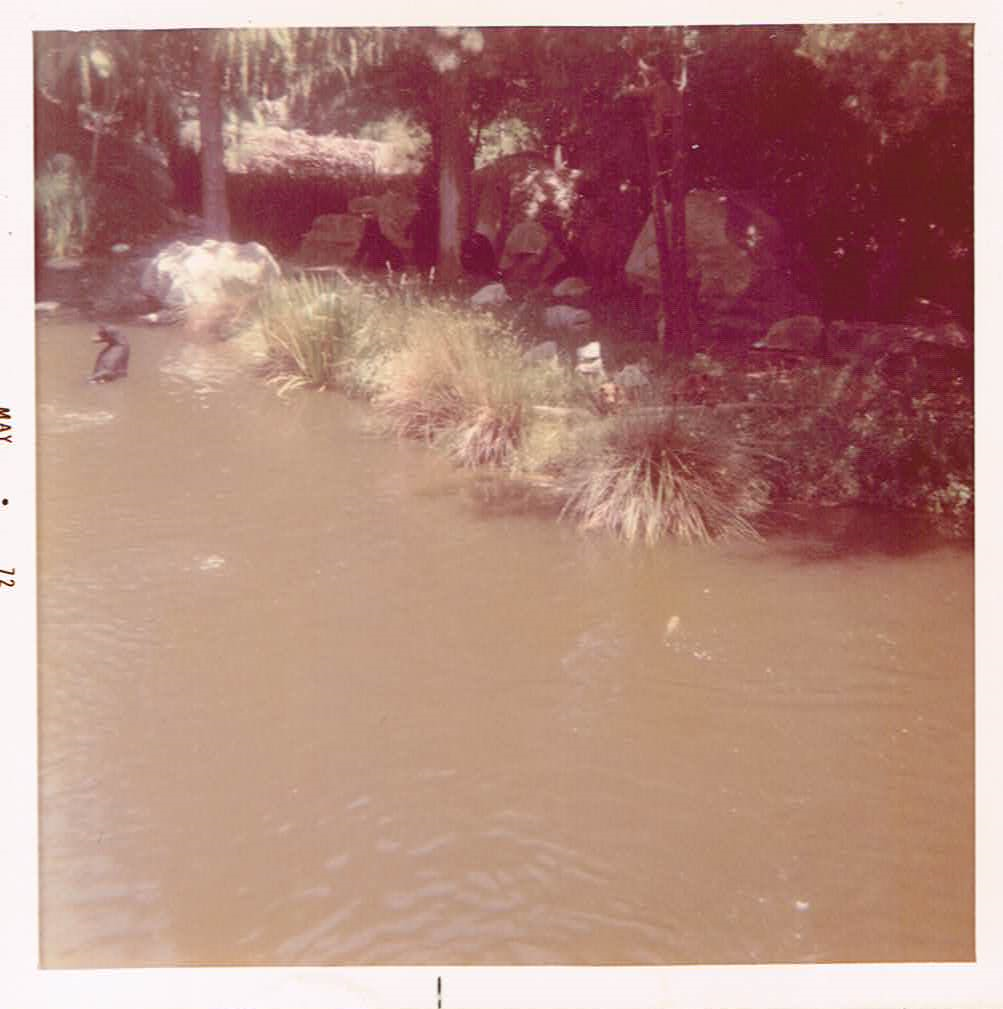
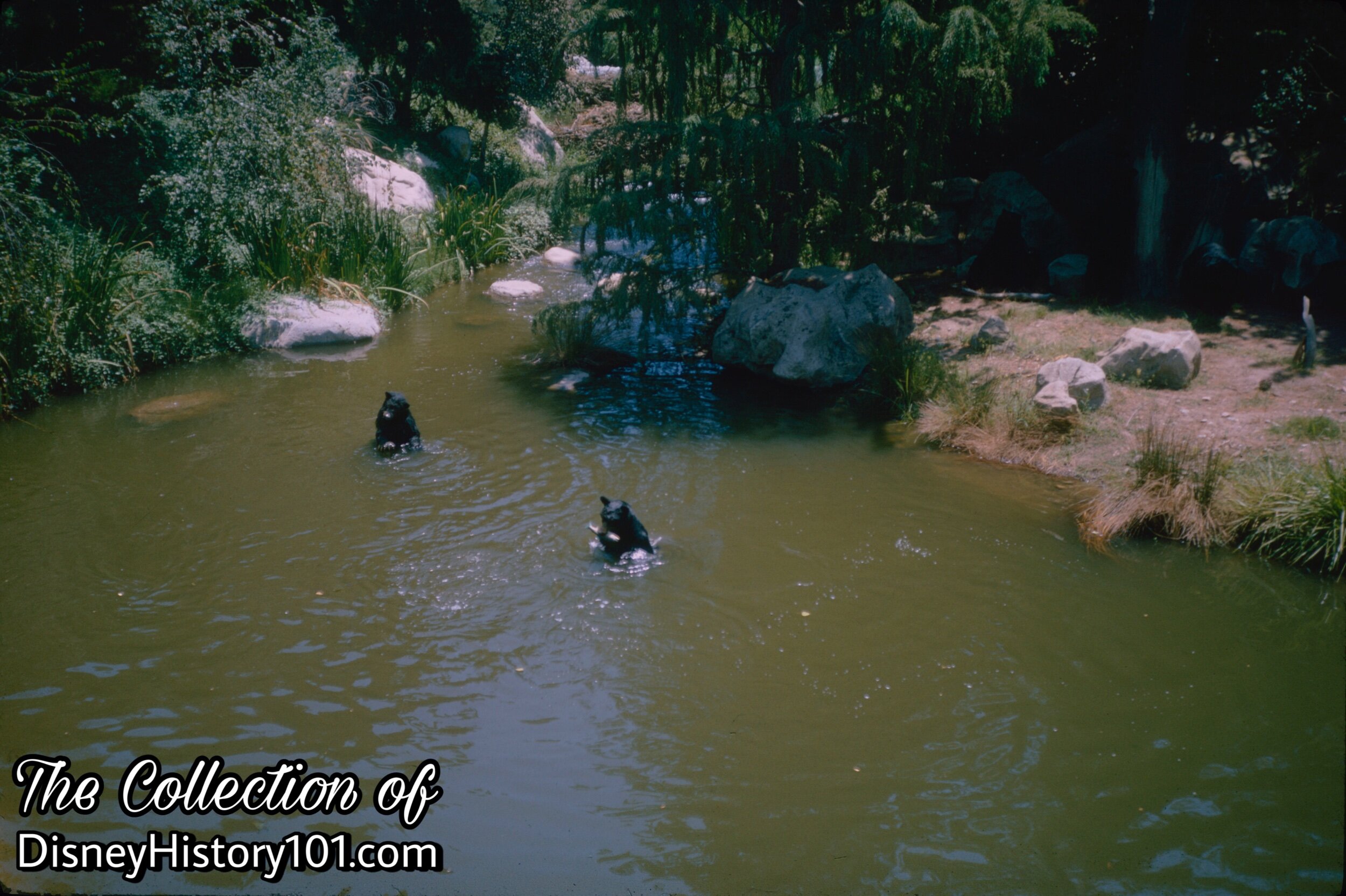
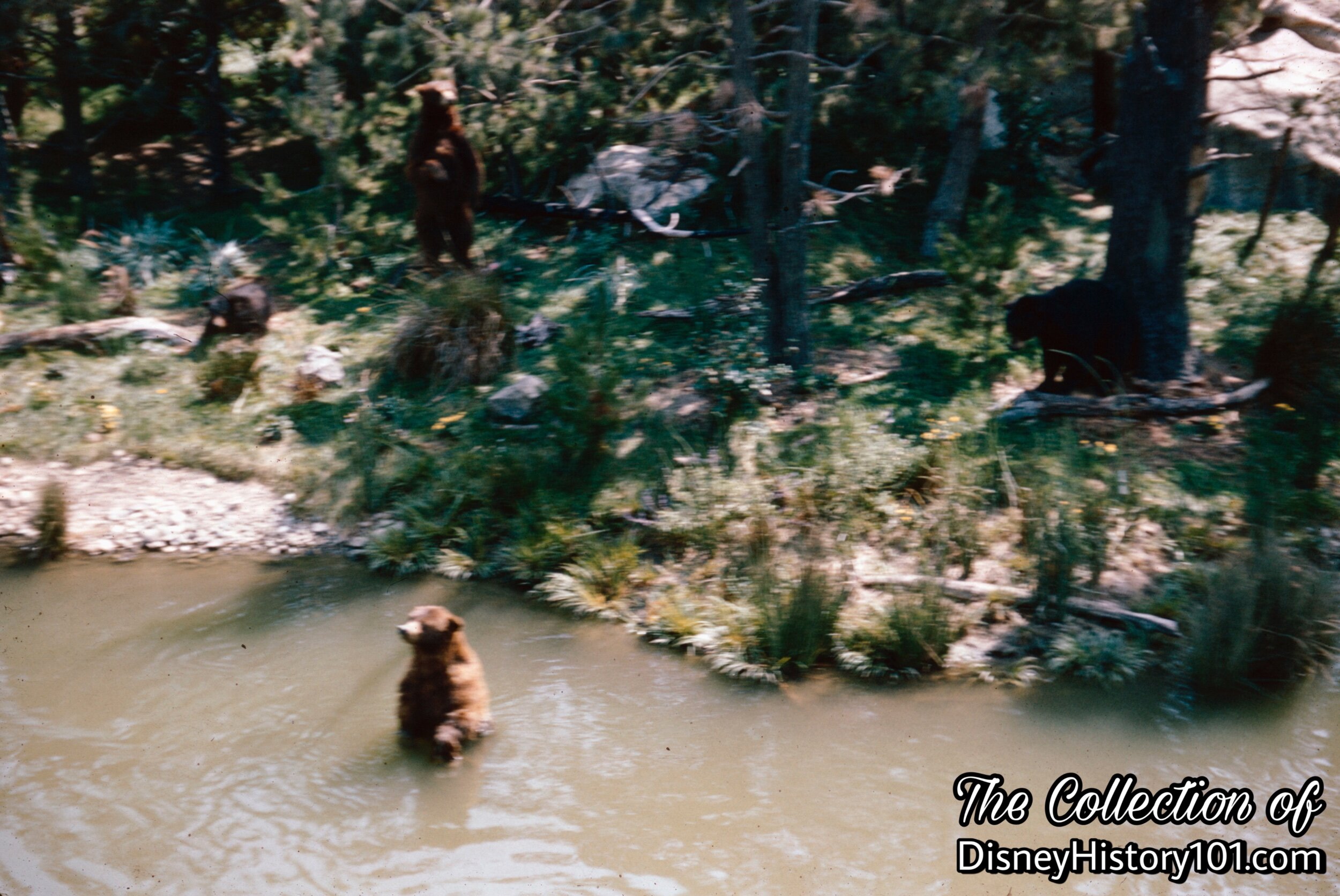
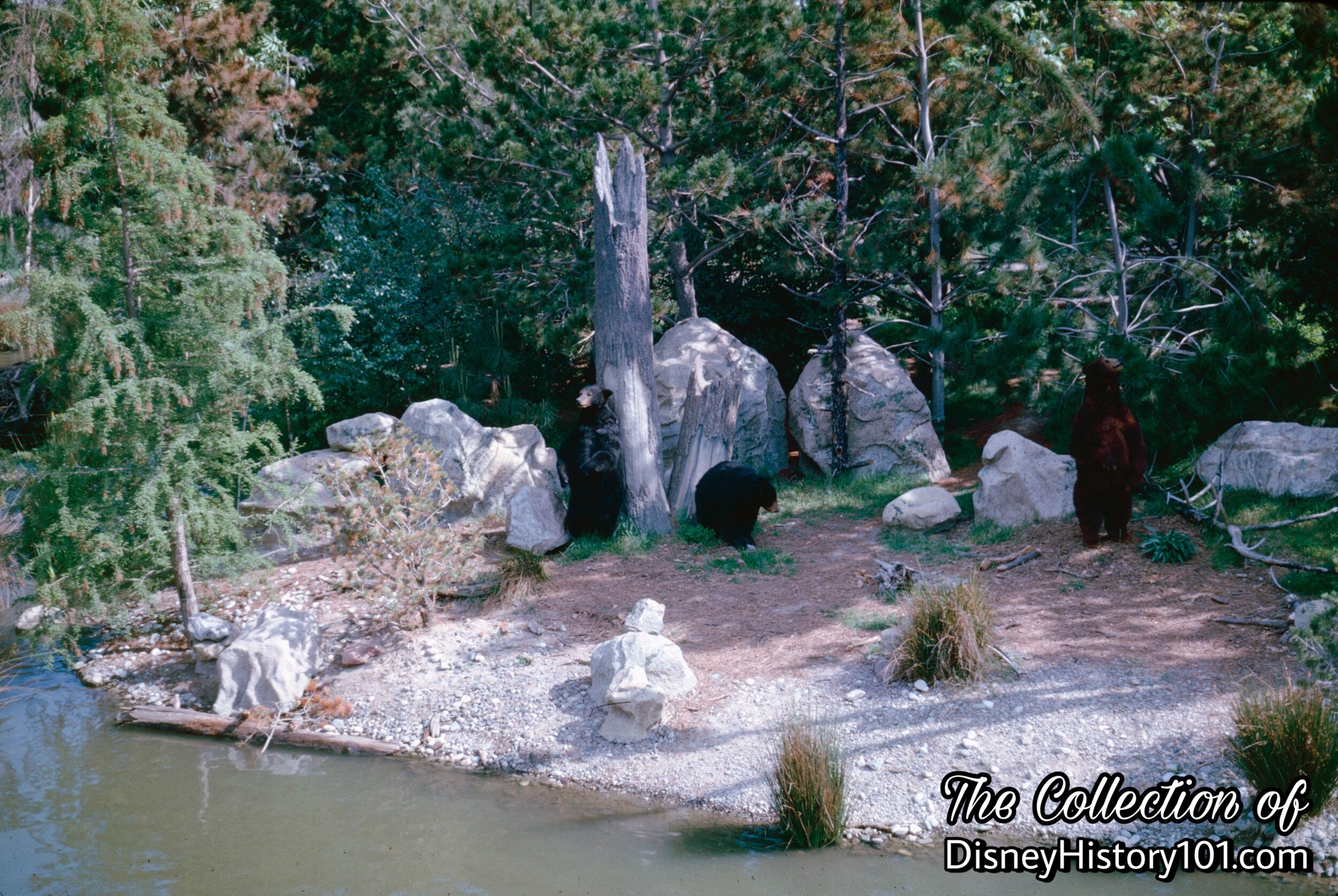
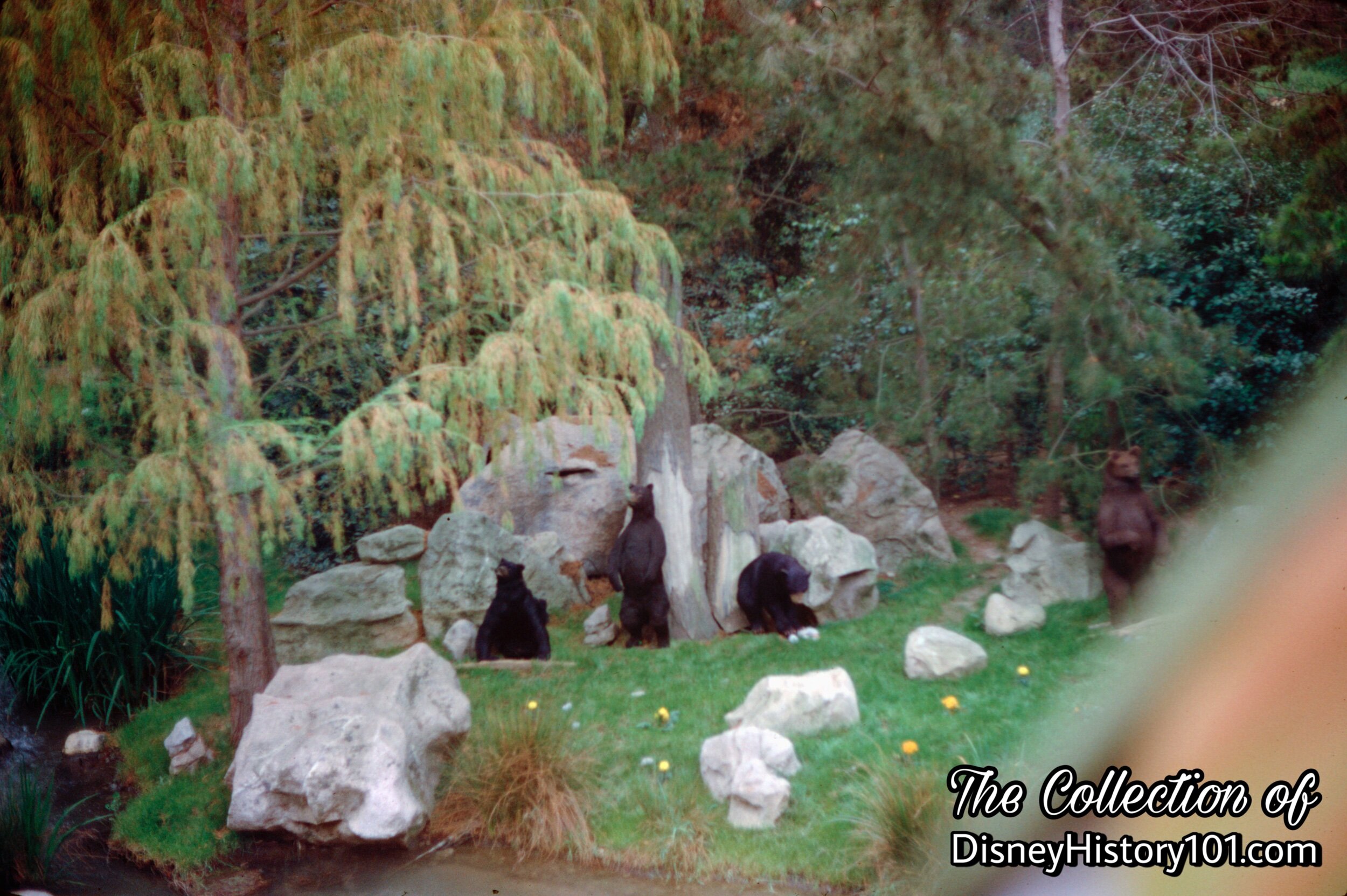

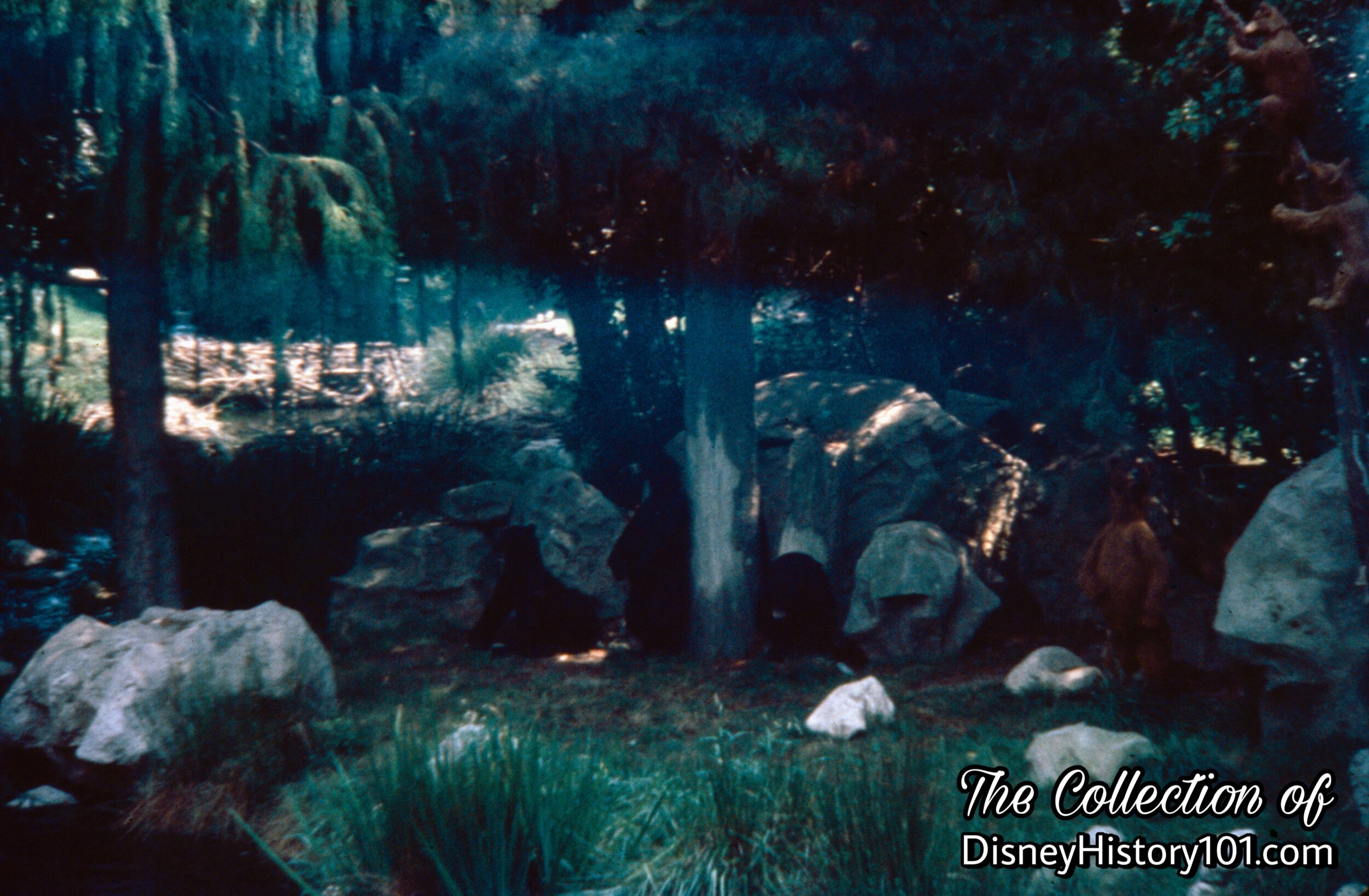
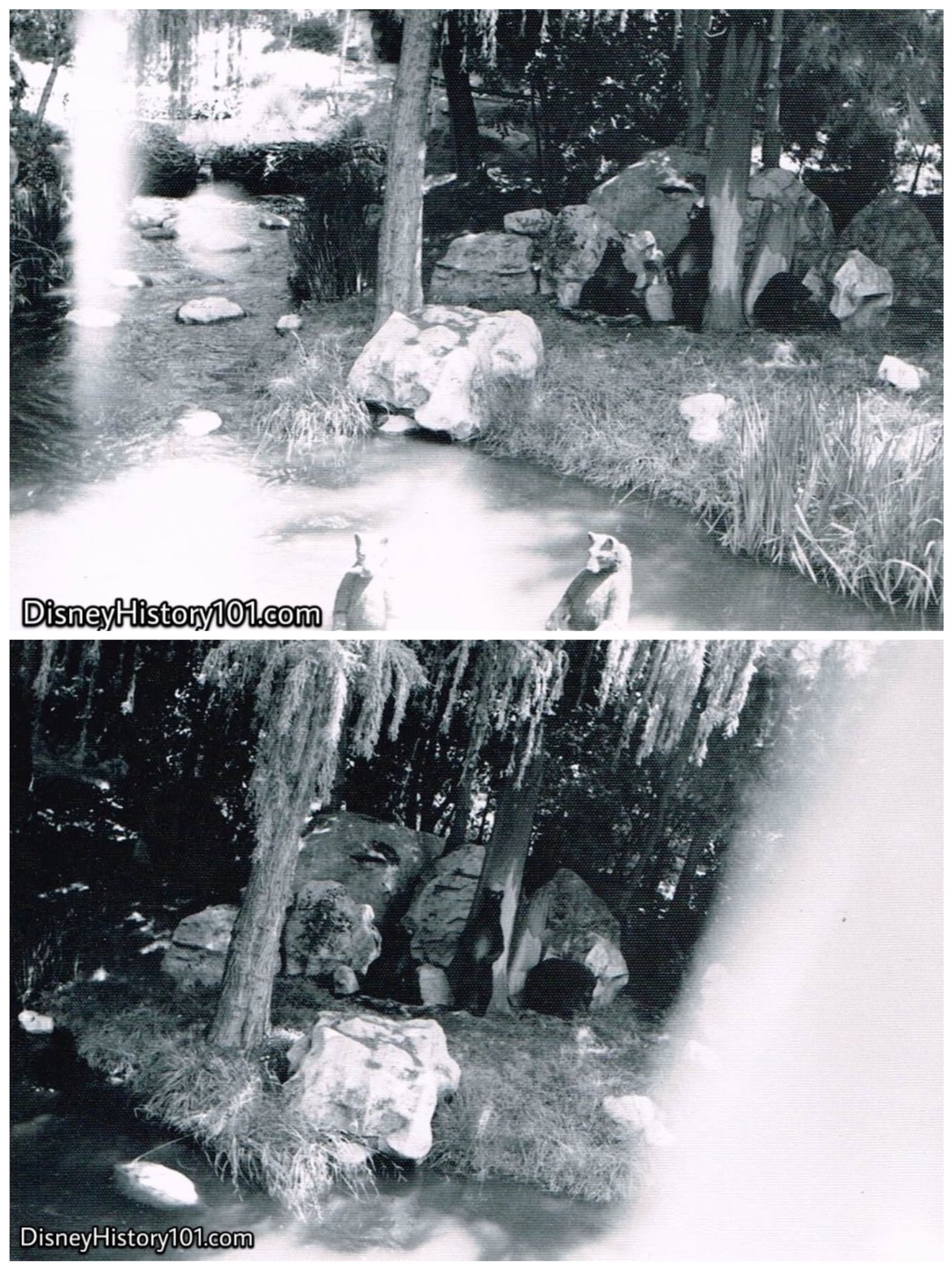
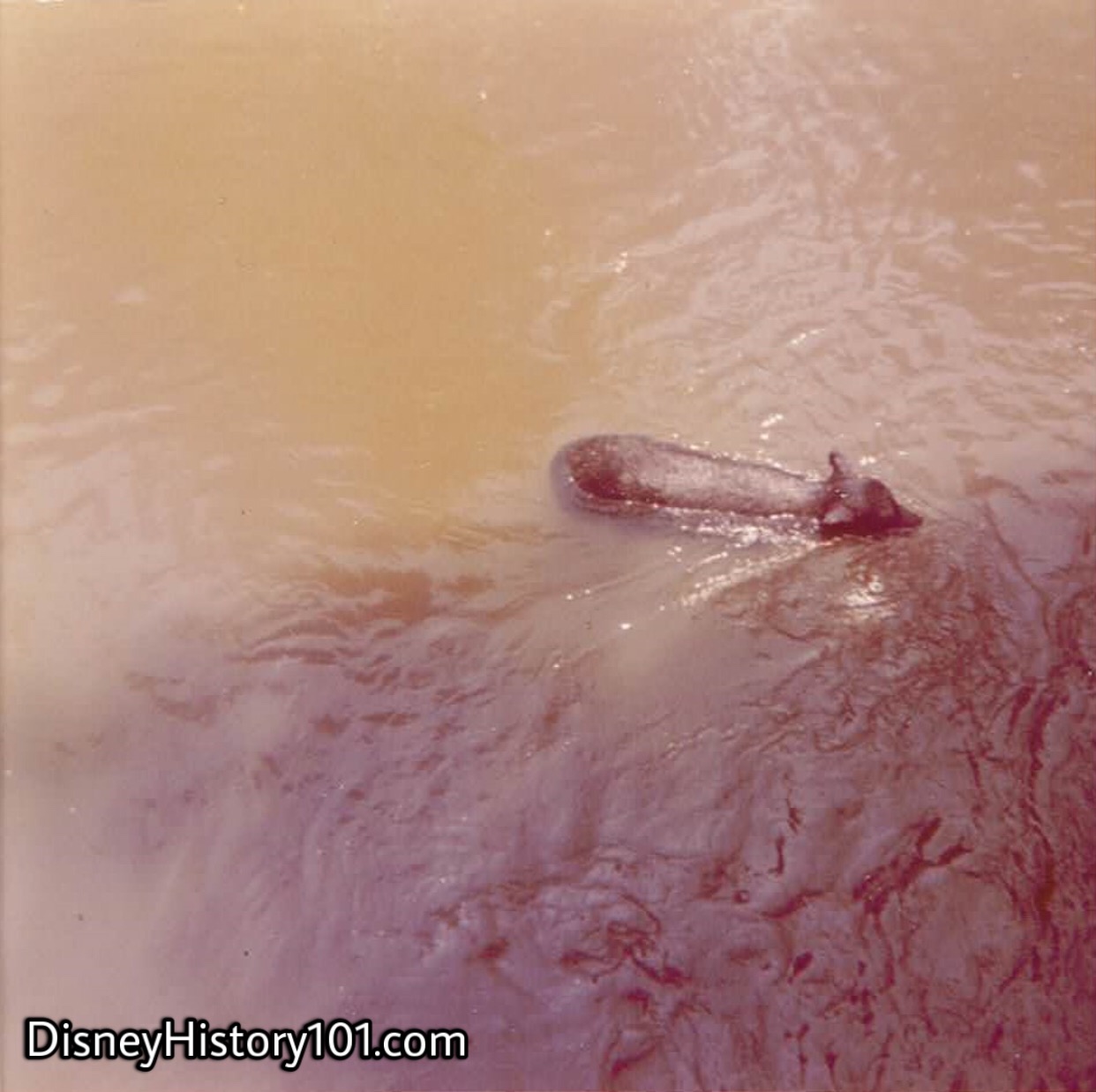
If you look off to the sides of the wooden trestle bridge, you’ll notice two swimming bears (one on each side of the Mine Train).
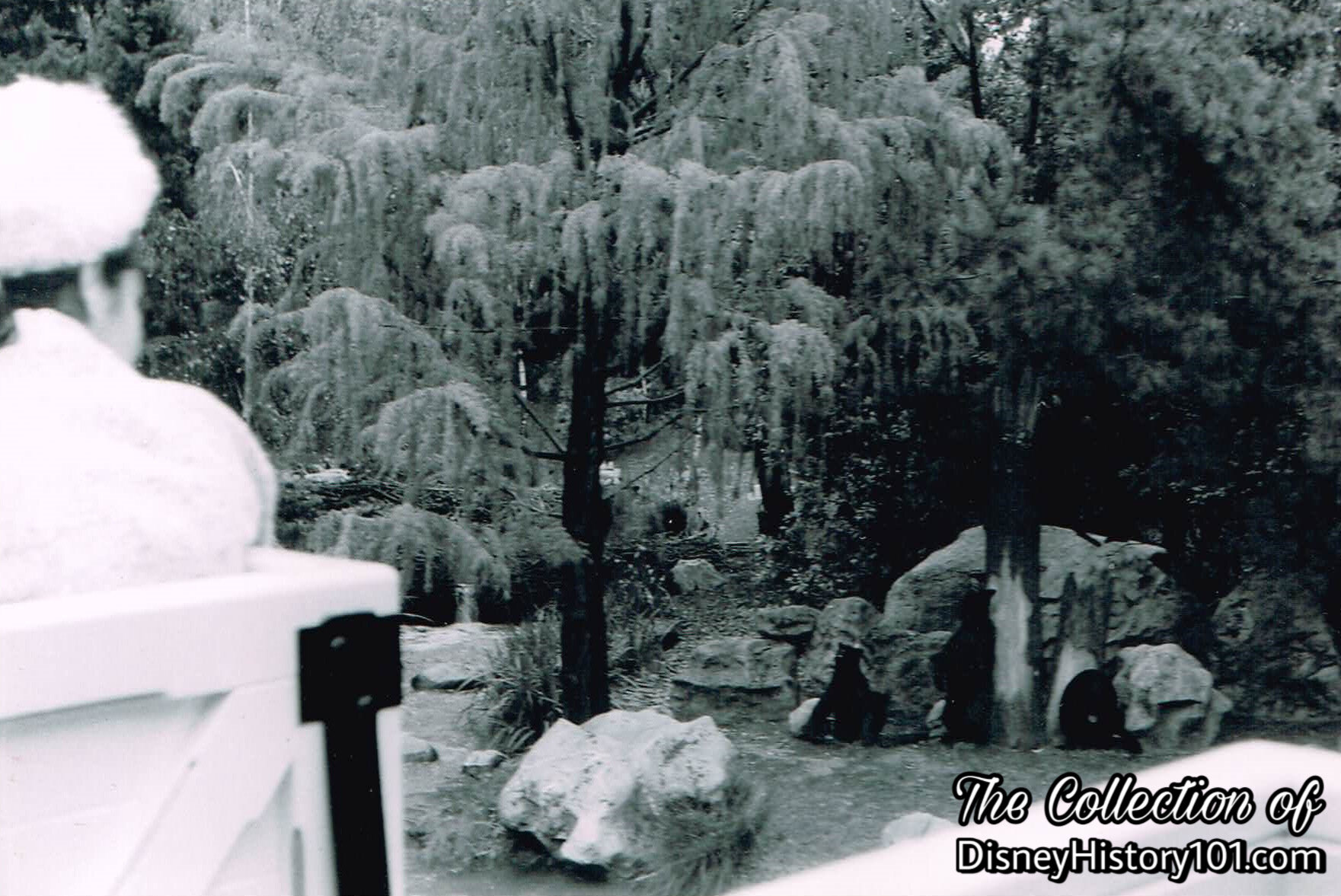
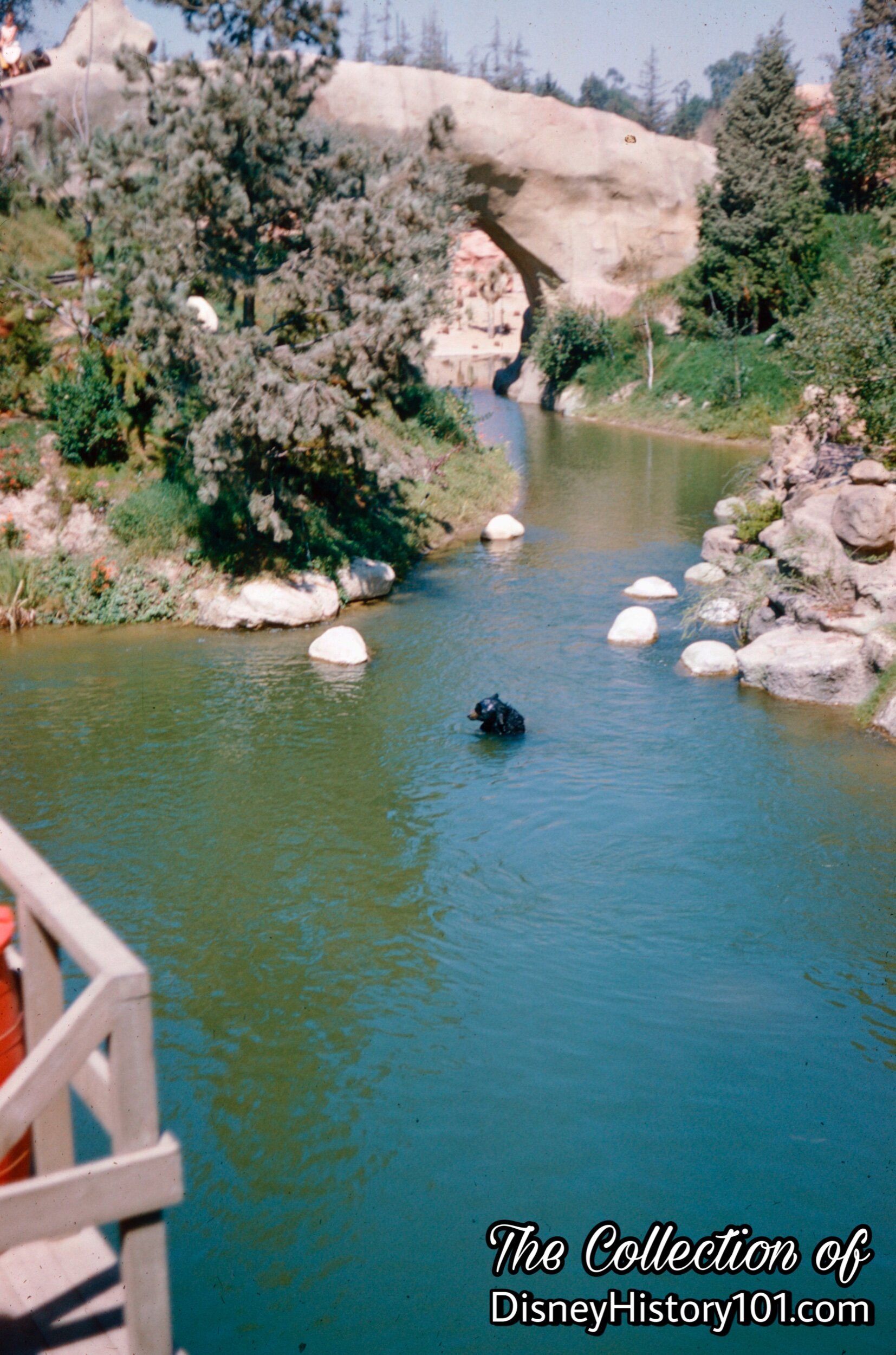
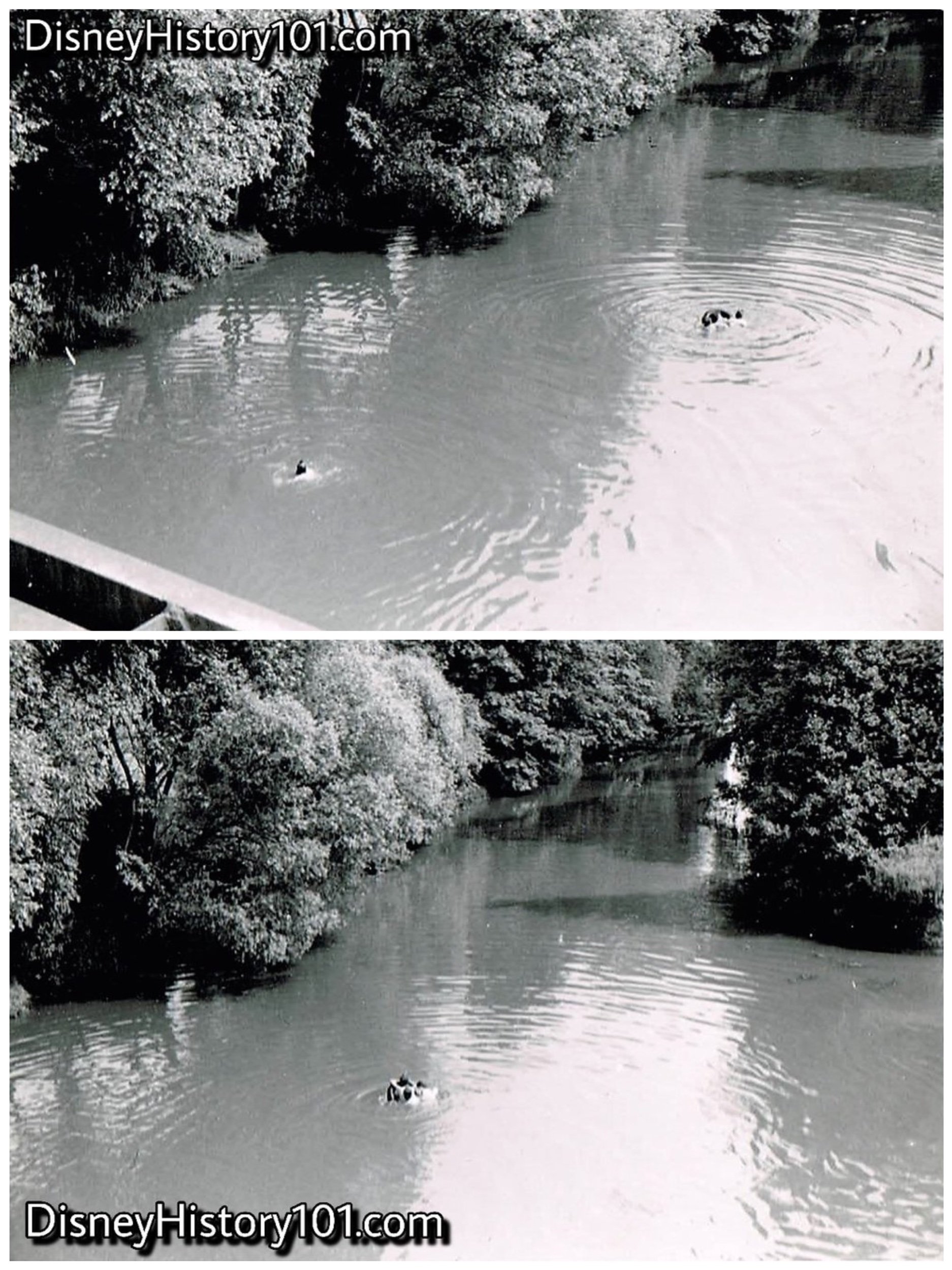
This was the scene as the train passed along a timber trestle over Bear Country. Some of these same jumping fish still inhabit an area near Big Thunder Mountain.

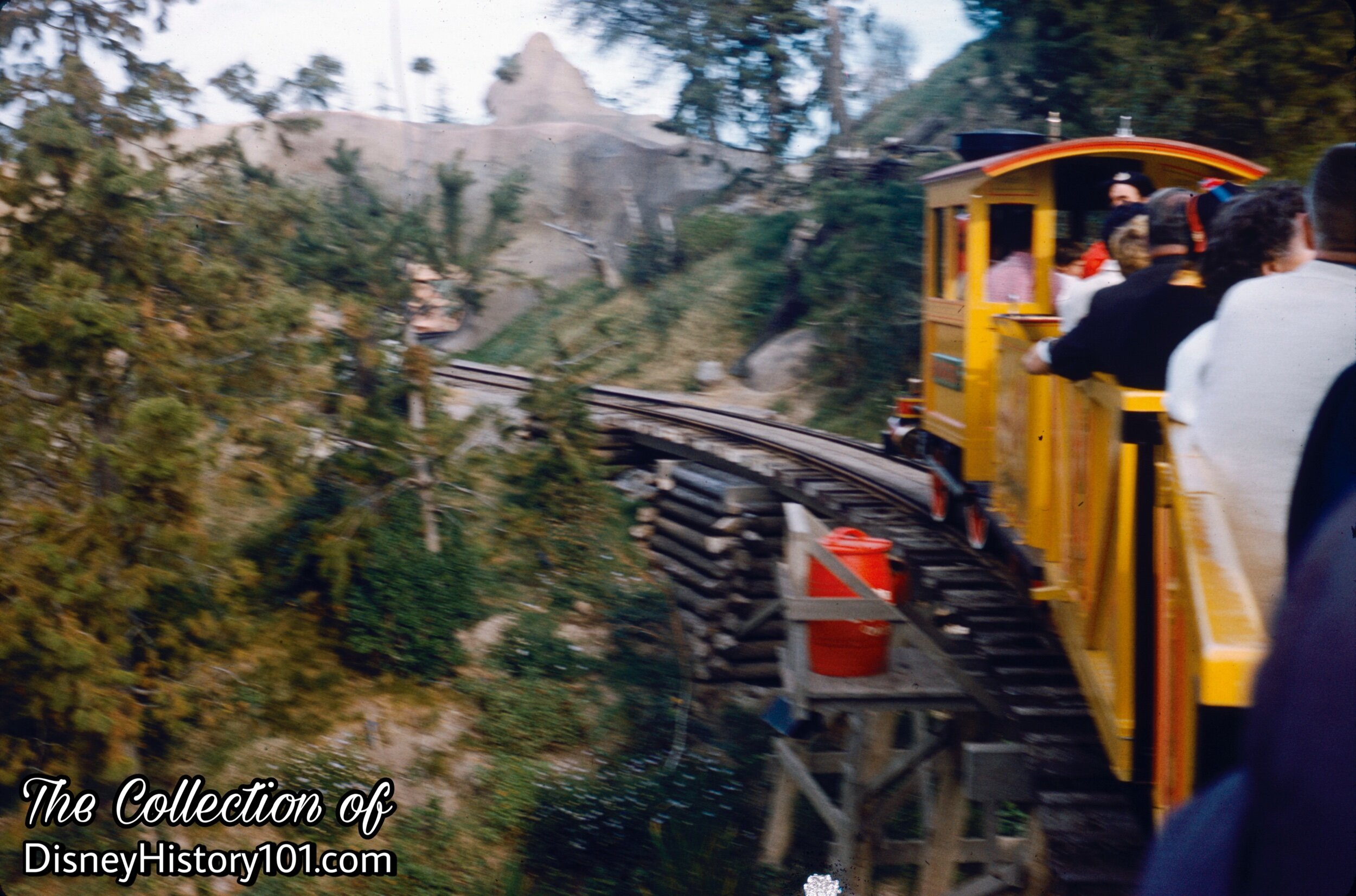
As we get to the other side of the wooden trestle, we hear what appears to be the sound of branches breaking.
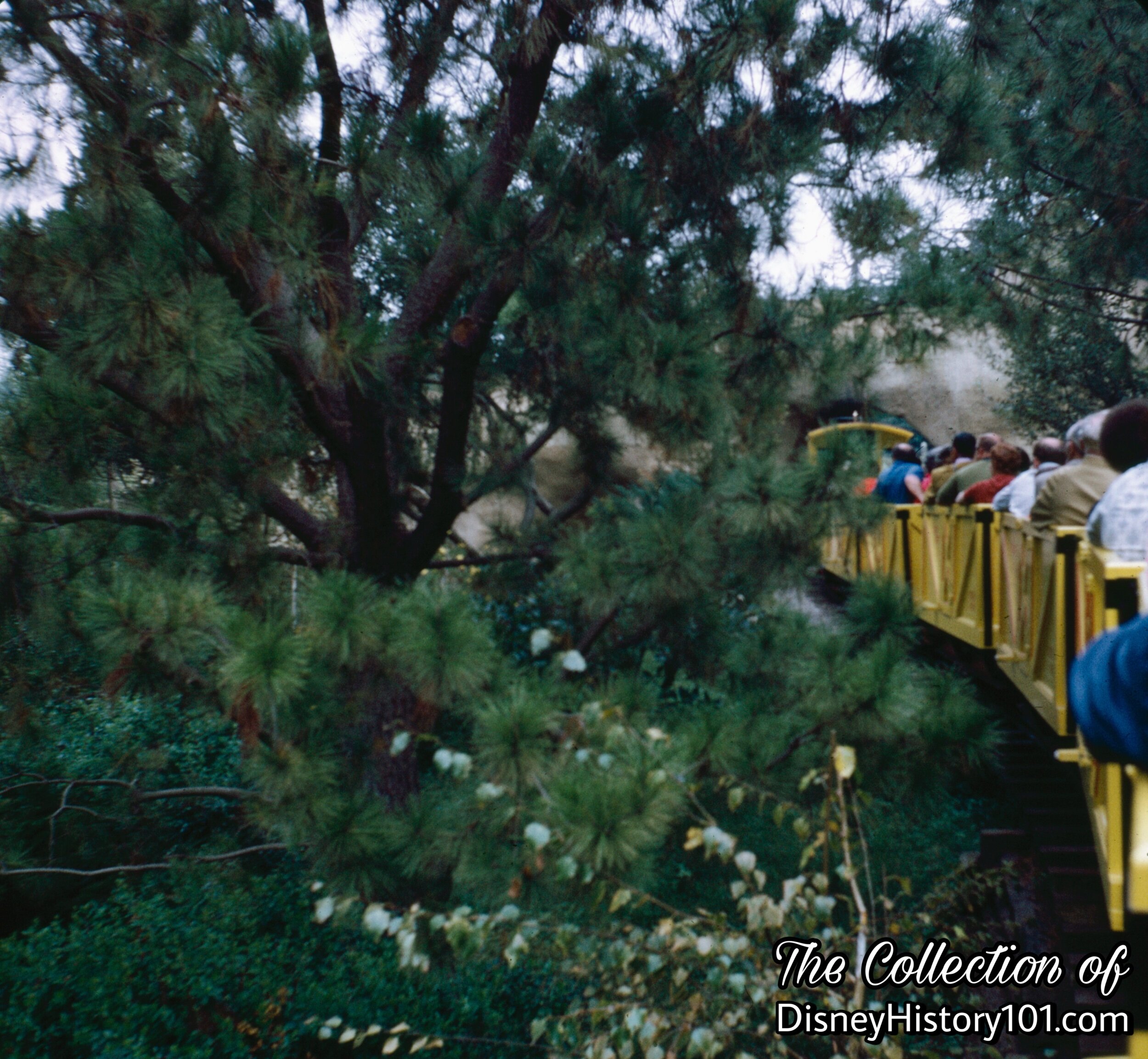
On the right, at the end of the trestle, we get quite a show!
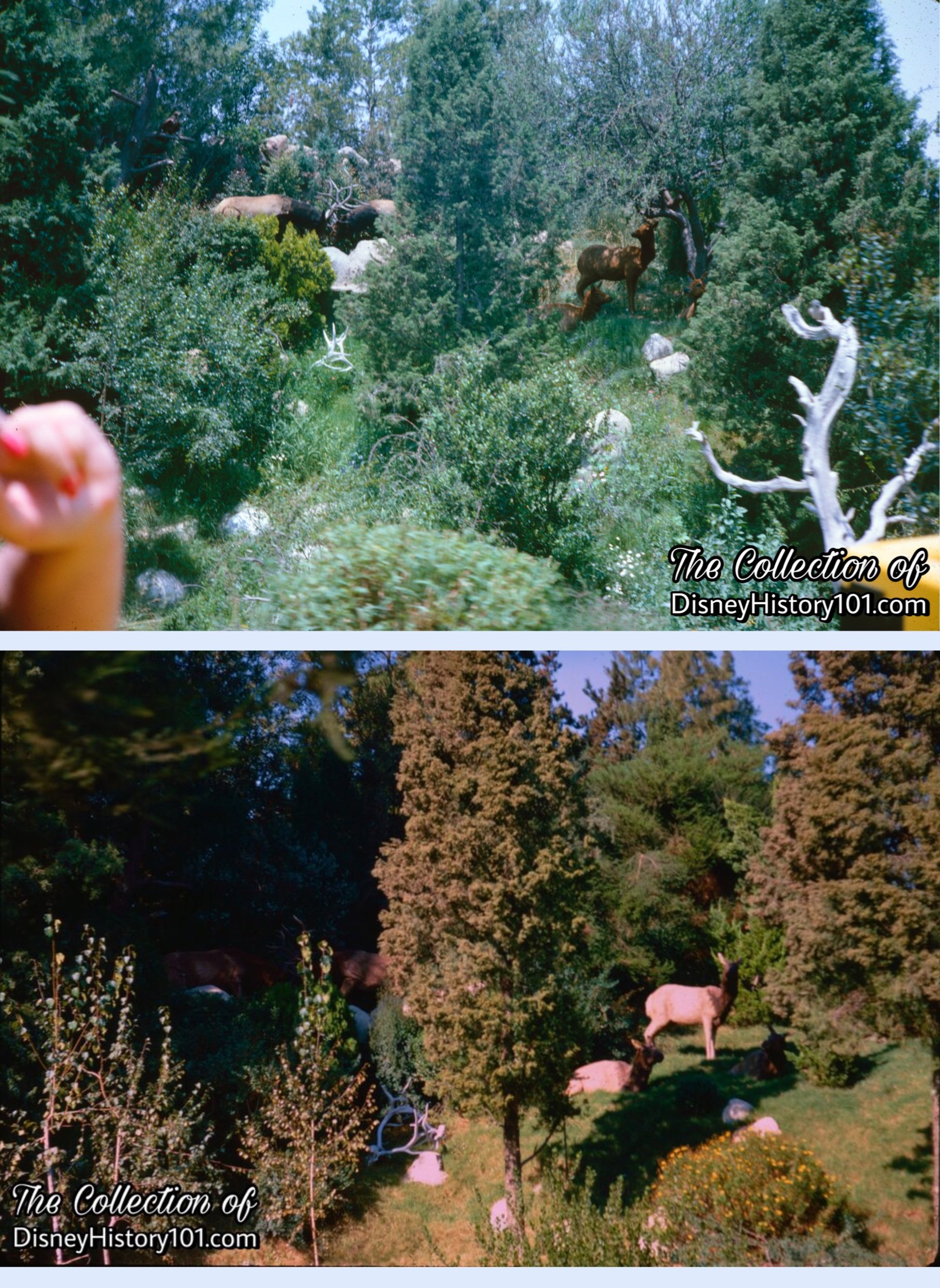
“Y’know Nature’s Wonerland can be awful pretty but sometimes she can be a mighty rugged place ta live. Out here in the wilderness, the struggle for survival leaves only the strong and sometimes the lucky. Say, look on that bank across Bear Creek there - now there’s a real struggle for survival. Two stags are battlin’ for them Cow Elk.”
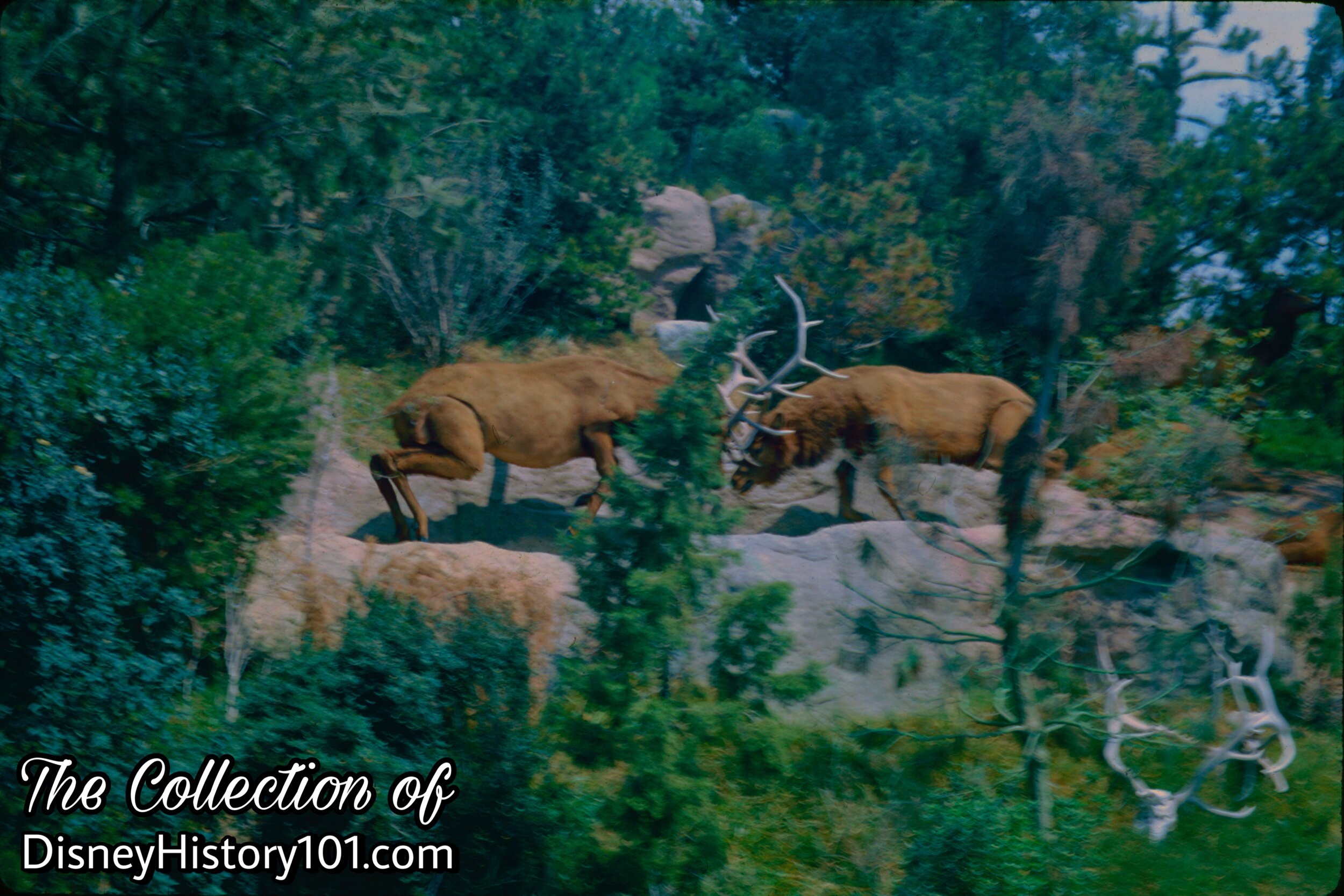
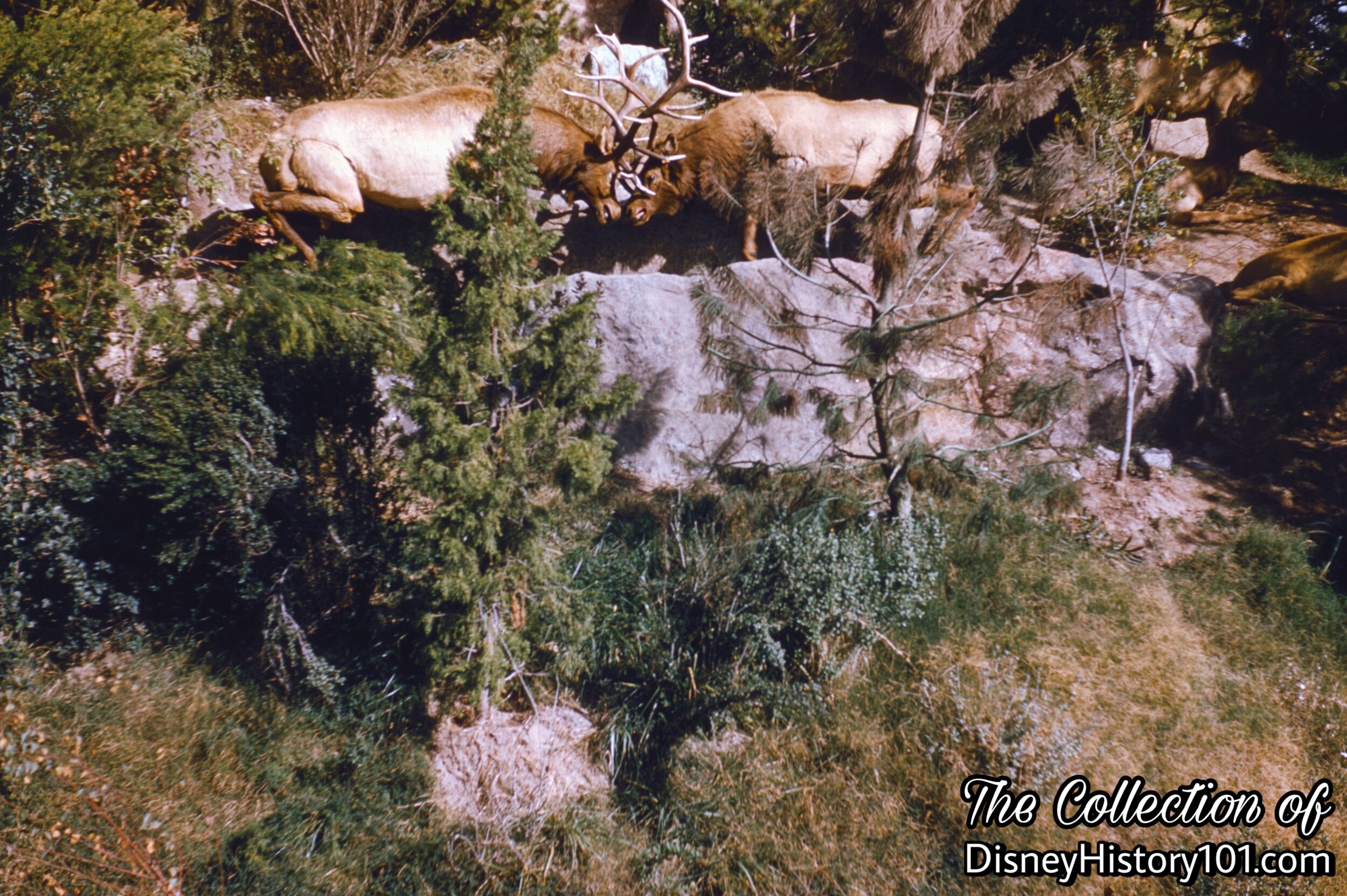
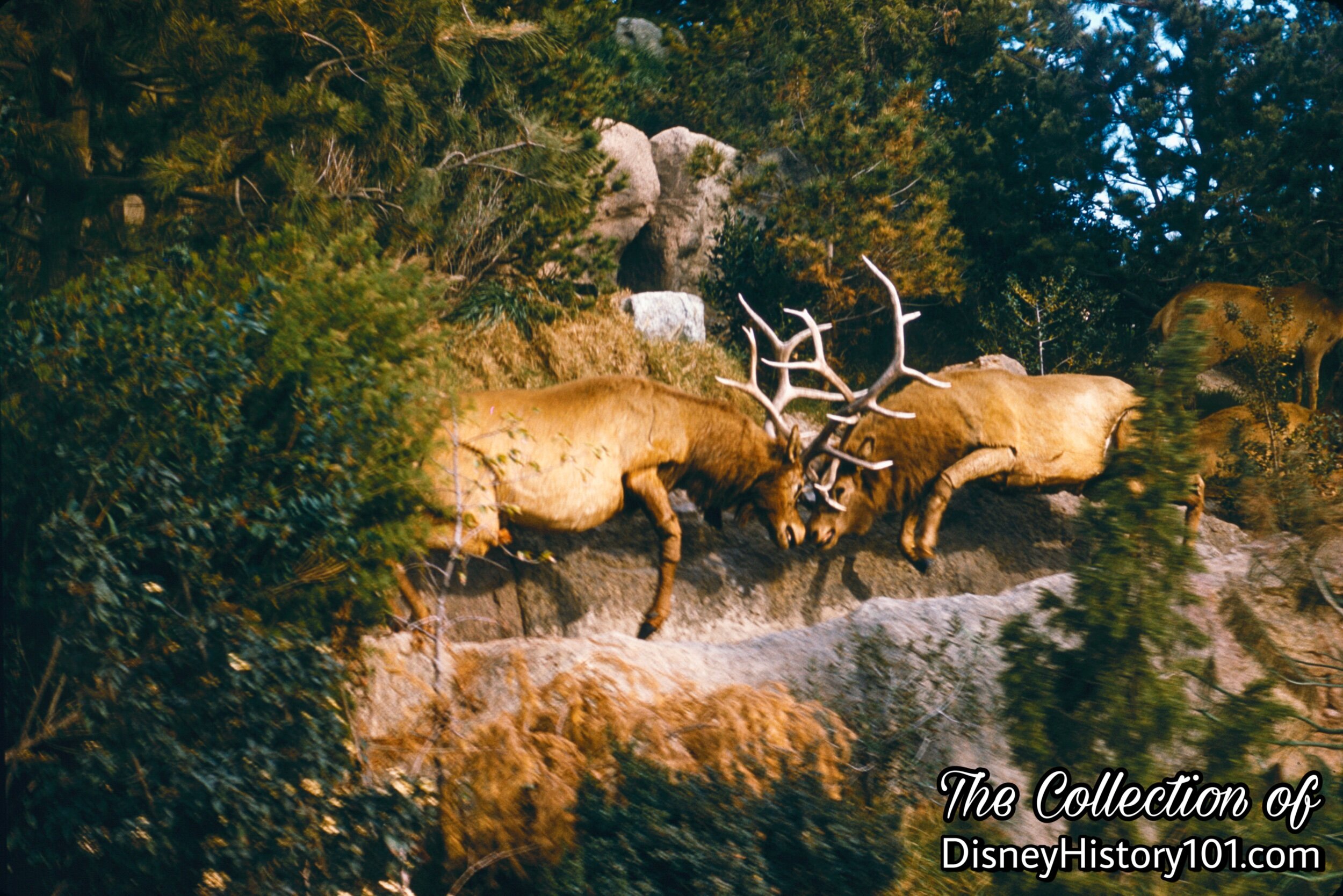
The battling Olympic Elk scene was derived loosely on an exciting scene in the 1952 RKO release The Olympic Elk - a True Life Adventure presented by Walt Disney Studios. Like most films of the True-Life Adventures series, The Olympic Elk “presented the strange facts about the world we live in”, and was directed by James Algar, produced by Ben Sharpsteen, with some script by Winston Hibler and others. Unlike Disneyland’s big show, the films were “photographed in their natural settings” and were “completely authentic, unstated, and unrehearsed” - or, so read the opening dialogue.
True-life Bull Elk maneuver harems of cow elk as they migrate and graze through meadow pastures and mountainsides. Challengers occasionally gather and ambitiously confront the herd of Bull Elk, where they engage in combat, and perchance become antler-locked.
Here at Disneyland, these six animated elk recreate the drama for passengers of mine trains. The Disneyland Welding Department would occasionally perform surgical work on the battling elks.

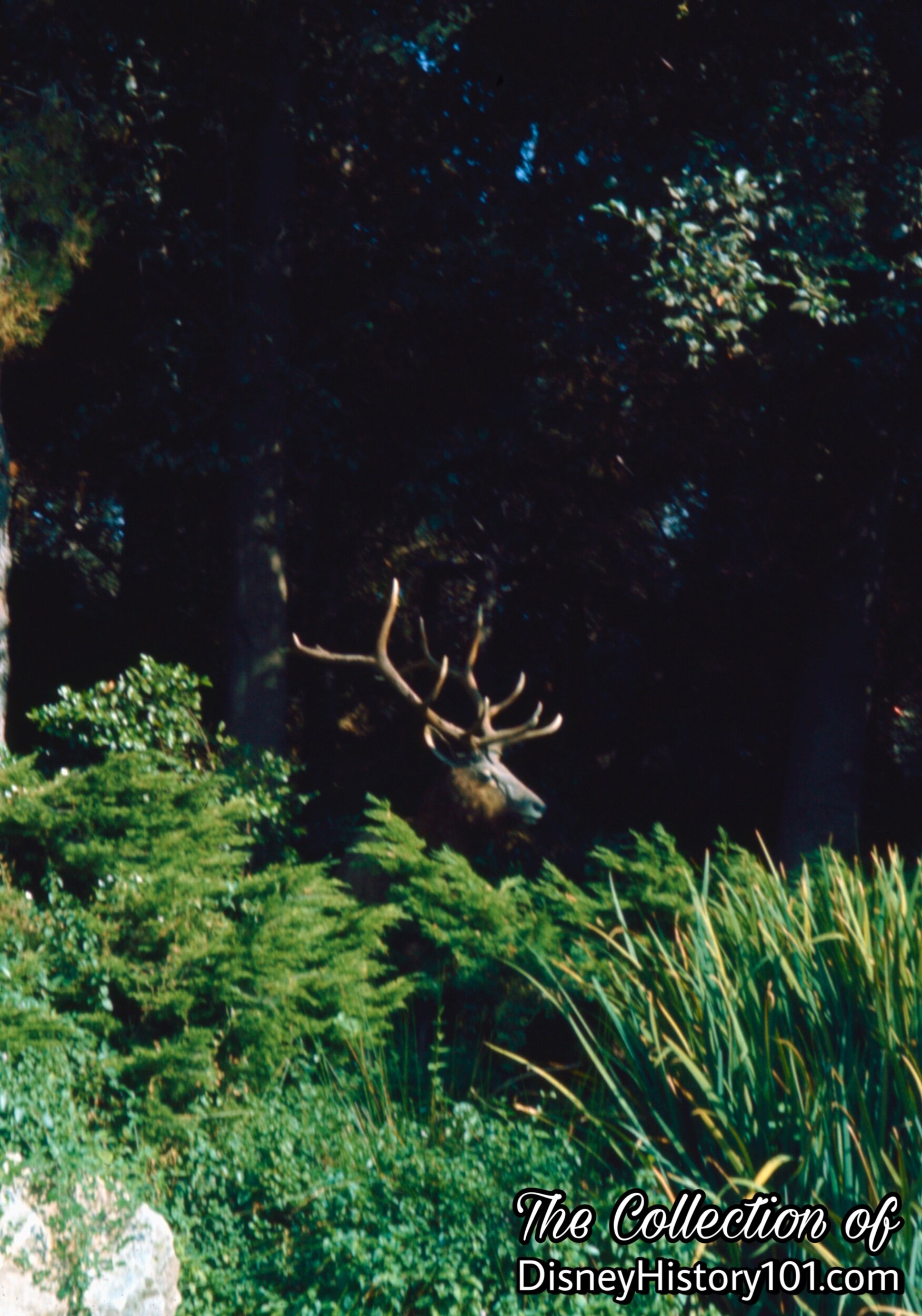
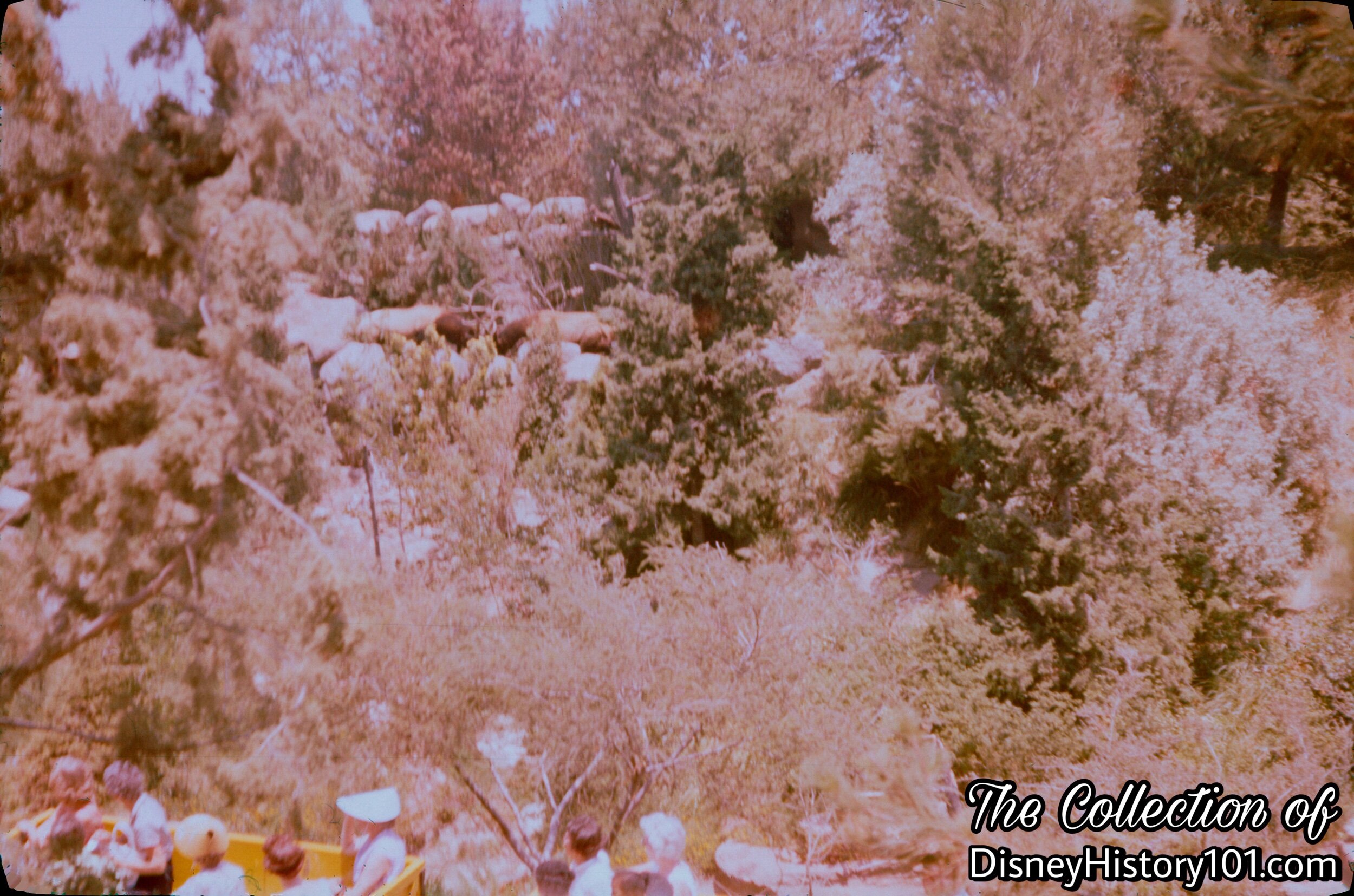
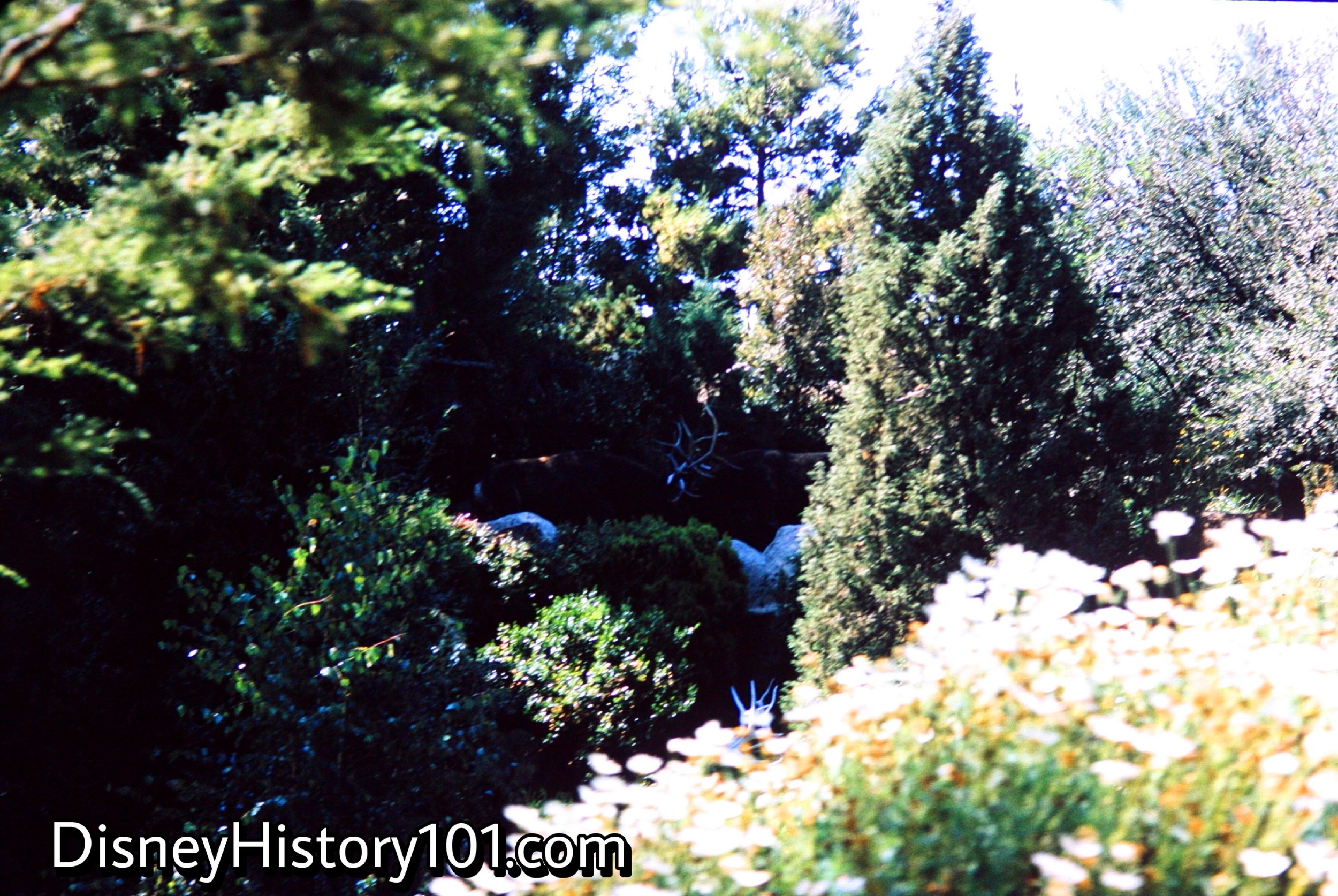
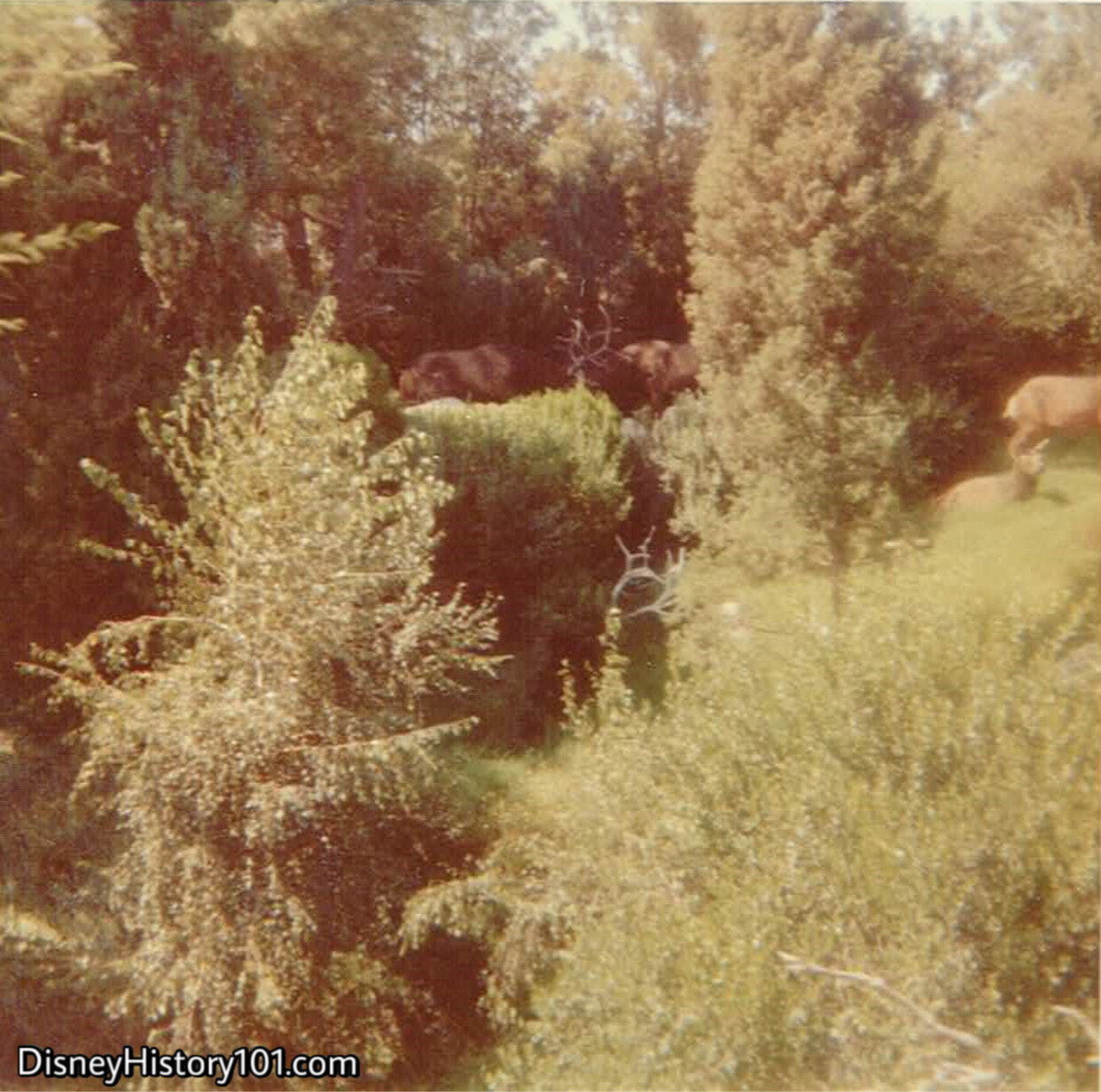
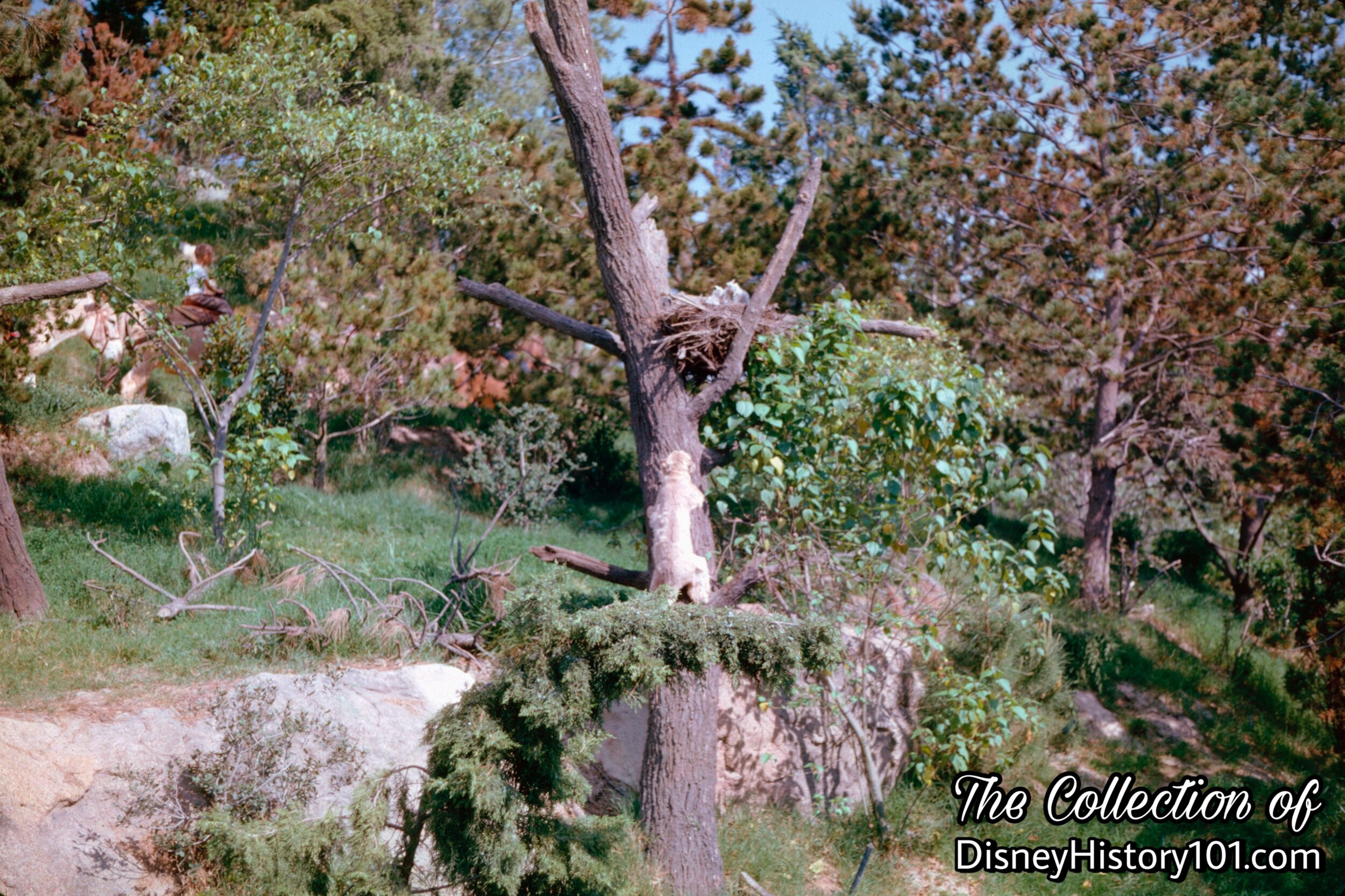
Ward Kimball would sure agree, that it is “tough to be a bird” in Nature’s Wonderland. A chorus sound of Meadow Larks, Mocking Birds, and Thrush can be heard in the distance as we come upon a sight - a hungry Bobcat attempting to ascend to the nest of a family of Red Tail Hawks!
Disneylander and “55er” John Gerlack recalled: “My job was to WAKE UP' the NATURE'S WONDERLAND birds. You see, their beak's mechanism would get rusty and they couldn't sing very well. I would hold the bird's beak open with one hand and with an eye dropper in the other hand, I would squirt some lubricating oil into the beak. Well, one Sunday, while I was at my bird waking chores, Walt slipped up silently and said, ‘How ya doin, Doc?’”
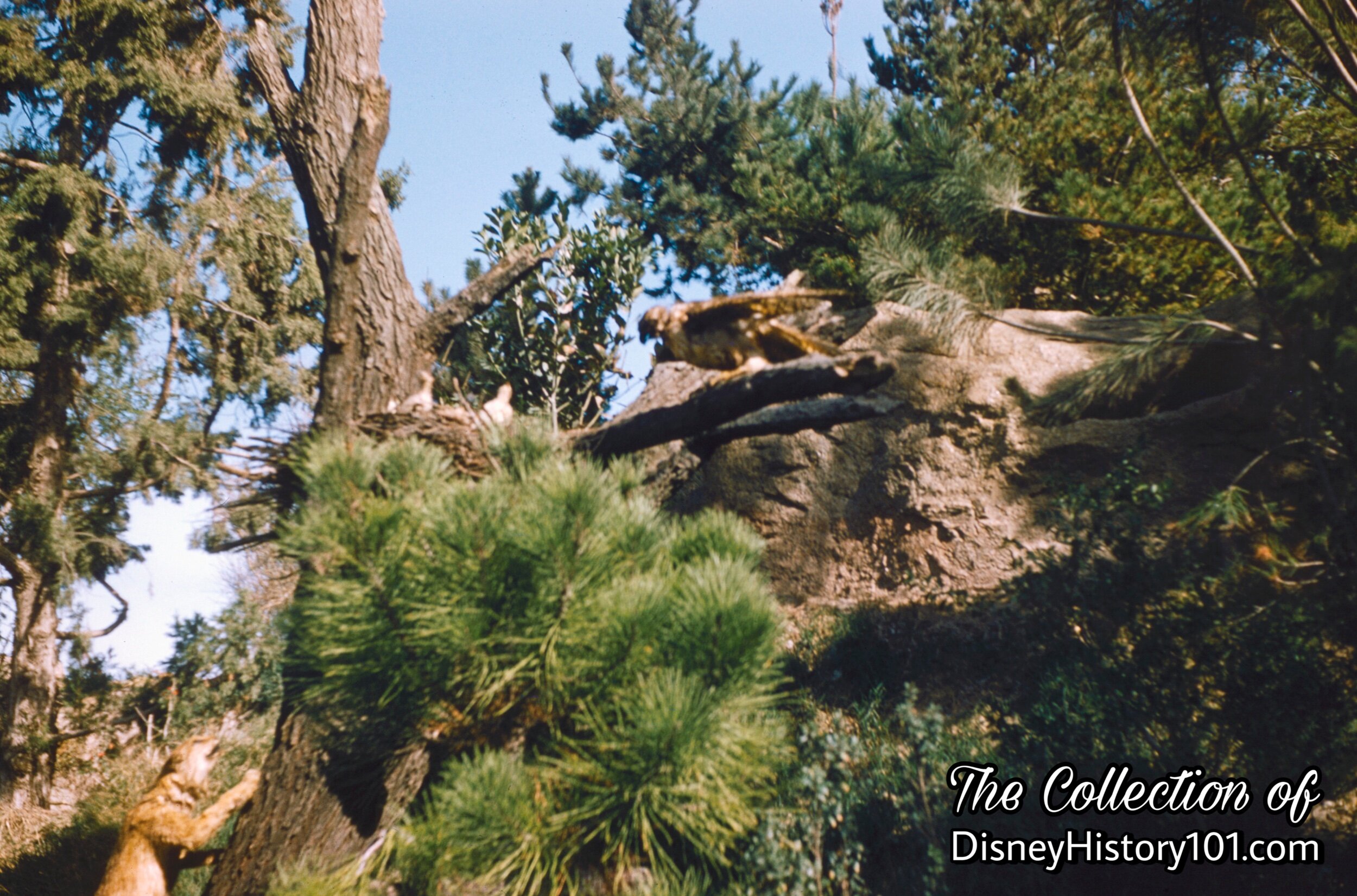
You may have heard the true-life tale of how the “nest of baby red-tail hawks (animated ones) so confused a mother hawk (real) that she tried to deposit dinner down their throats.” [Walt’s Animation Is Too Successful, Associated Press]
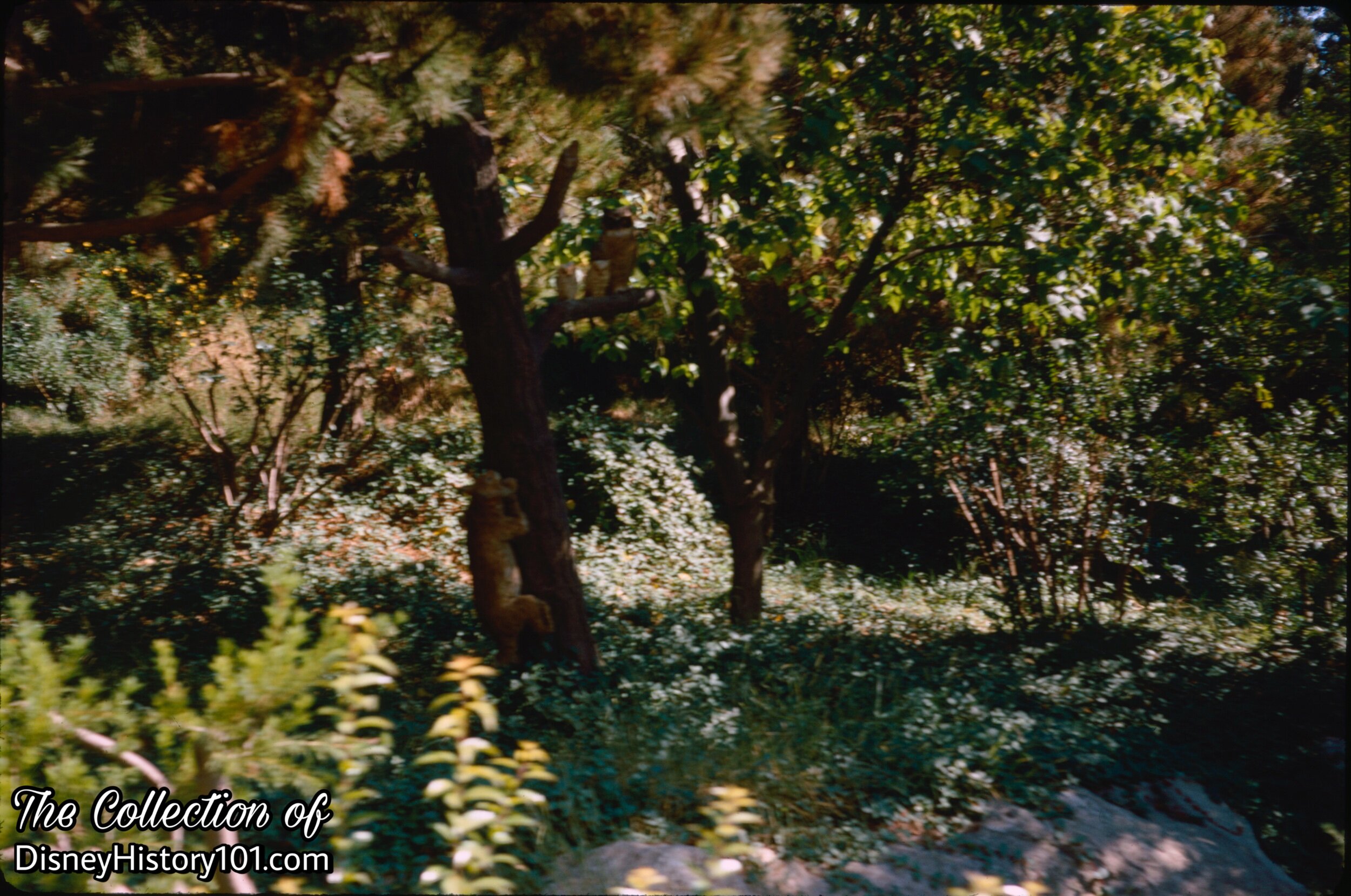
Not every animal character had a name, so I’ve decided to call the large bird “Hootsie the Owl.” You may have also heard another true-life account of how “Hootsie” and other owls around Nature’s Wonderland were “being pecked into the repair shops by frustrated but real crows and blackbirds.” This sort of thing was happening as far back as 1964, according to “Walt Disney Disneyland,” page 44, printed by Officine Grafiche Arnoldo Mondadori - Verona; first published 1964. It’s a fact that the Blackbirds have also been known to attack animated ravens around these Frontier parts. [Walt’s Animation Is Too Successful, Associated Press]
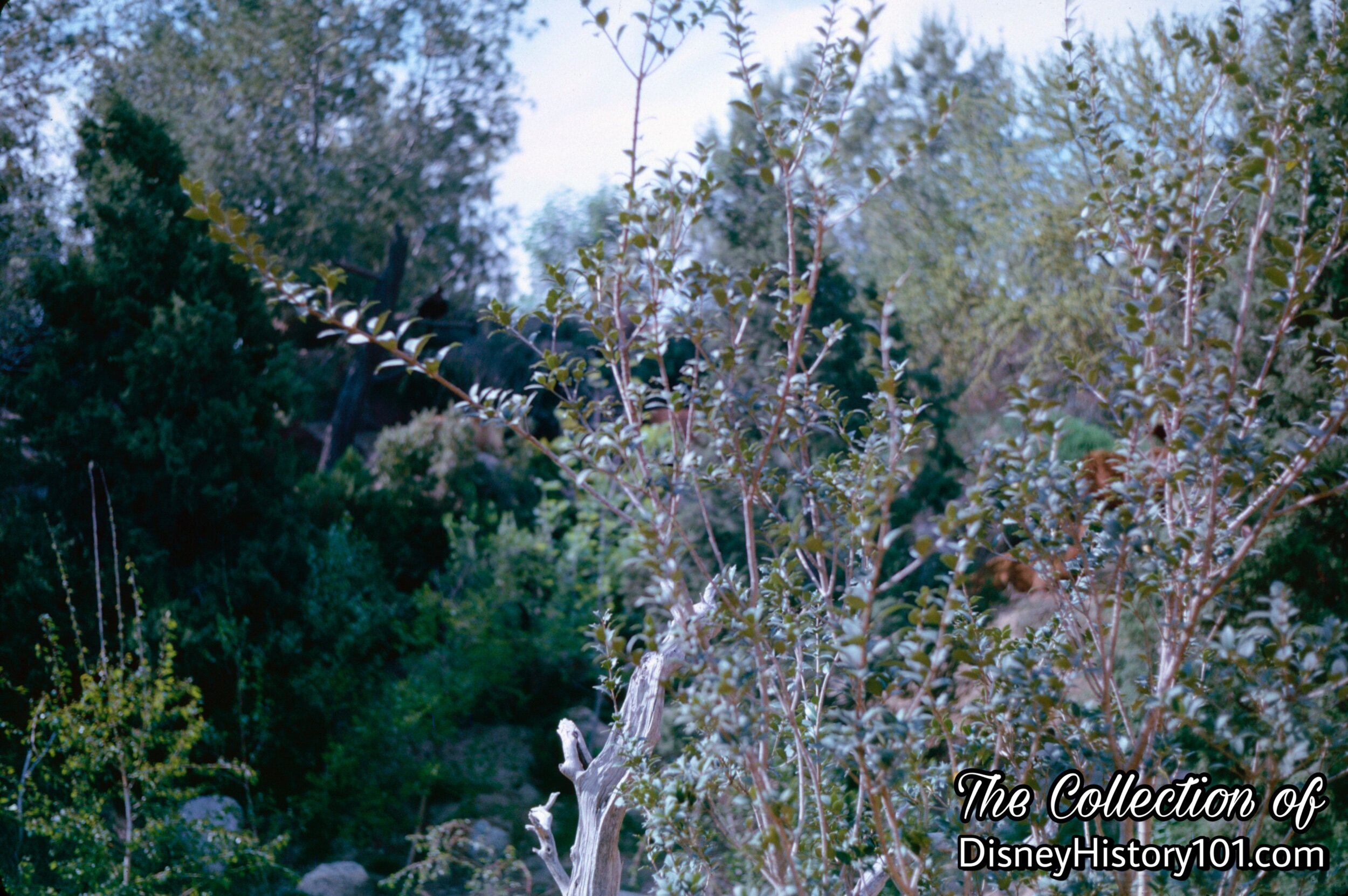
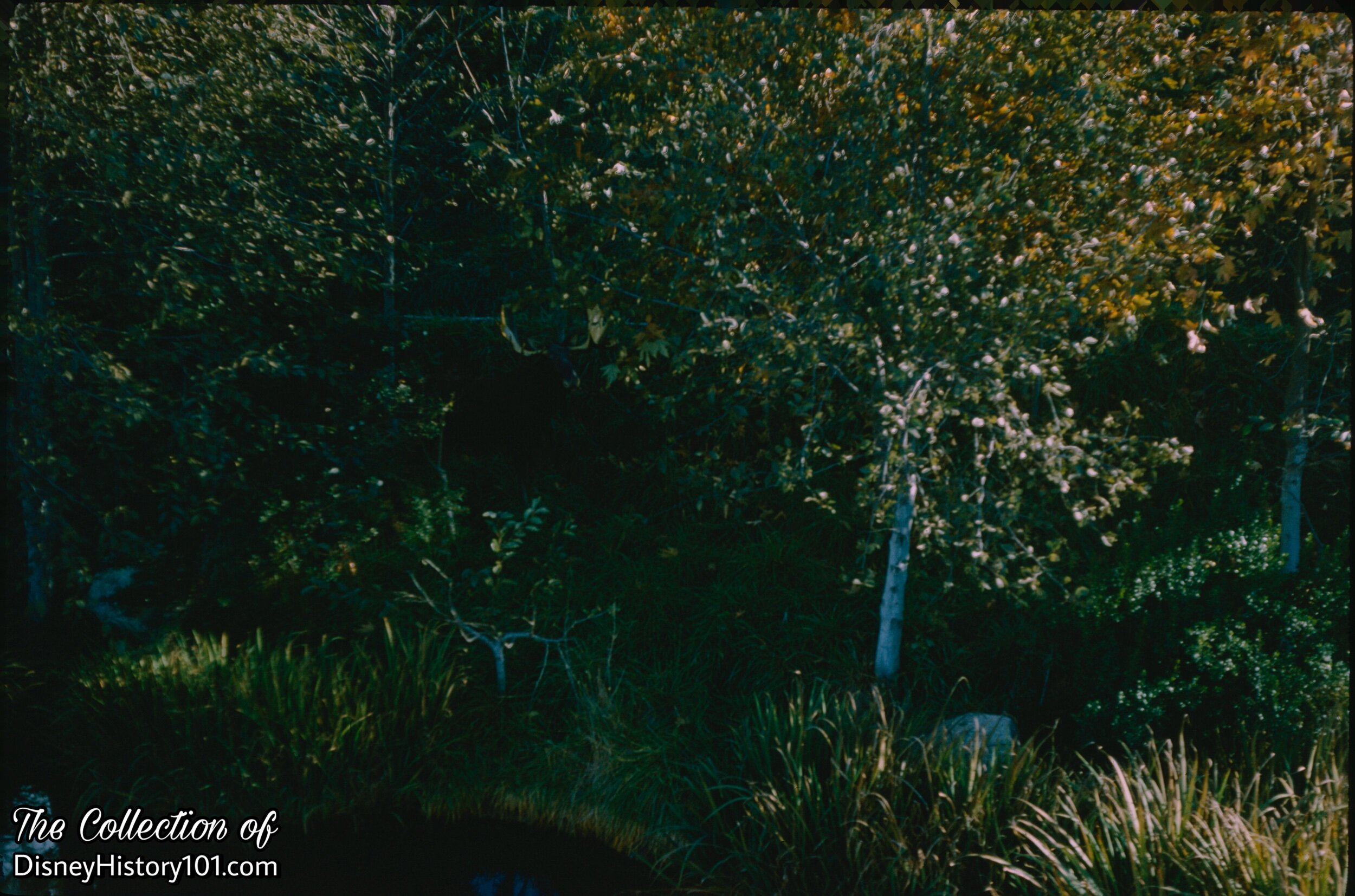
Moose in thicket.
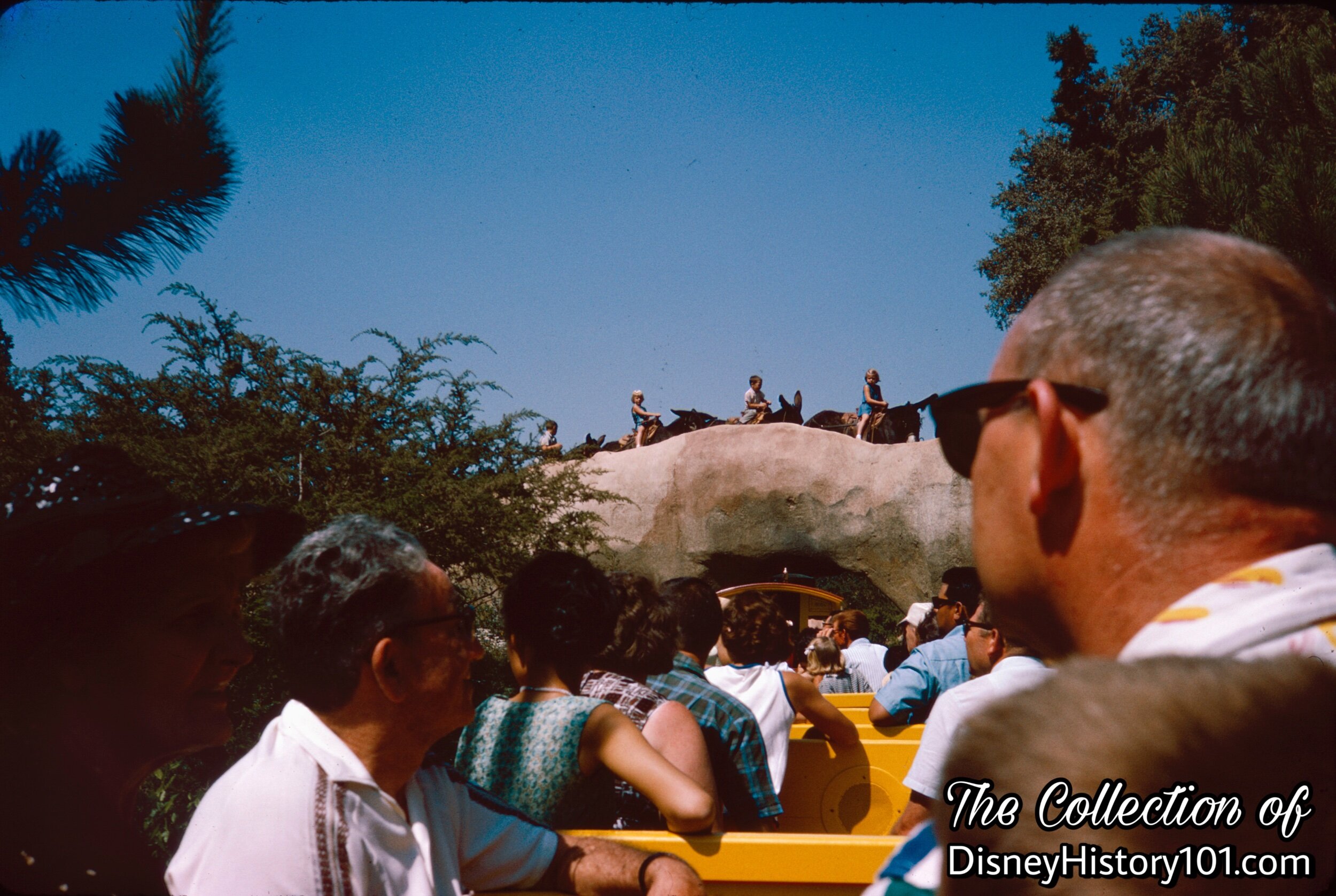
As we pass through ol’ Natural Arch Bridge, a passing Mule Train looks upon the great Living Desert down below. As we pass through Natural Arch Bridge, we’ll refrain from blowing our whistle or ringing the bell of the engine. We also ask our guests to maintain their silence. The reason, is so as not to disturb the mule train crossing overhead.
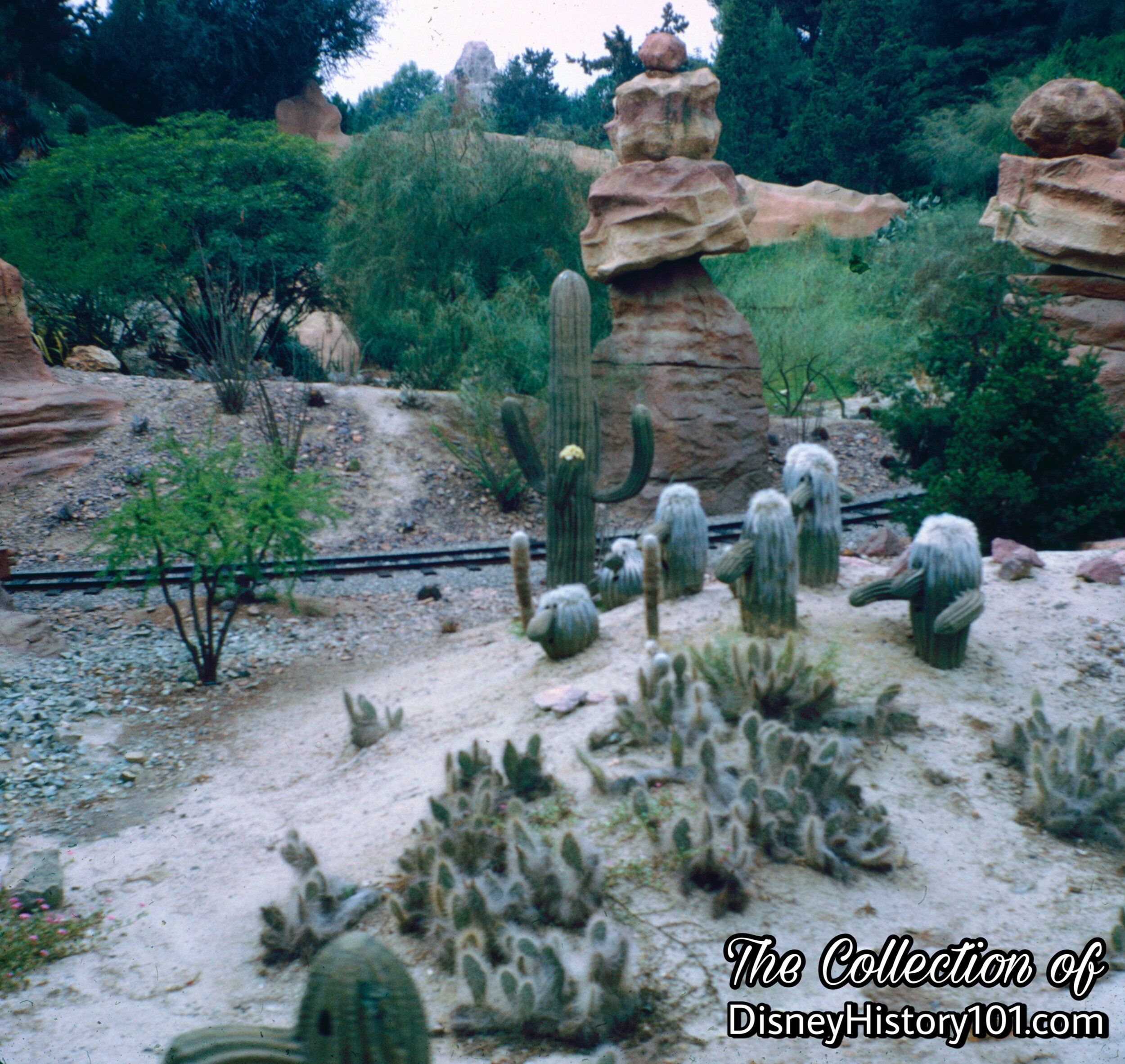
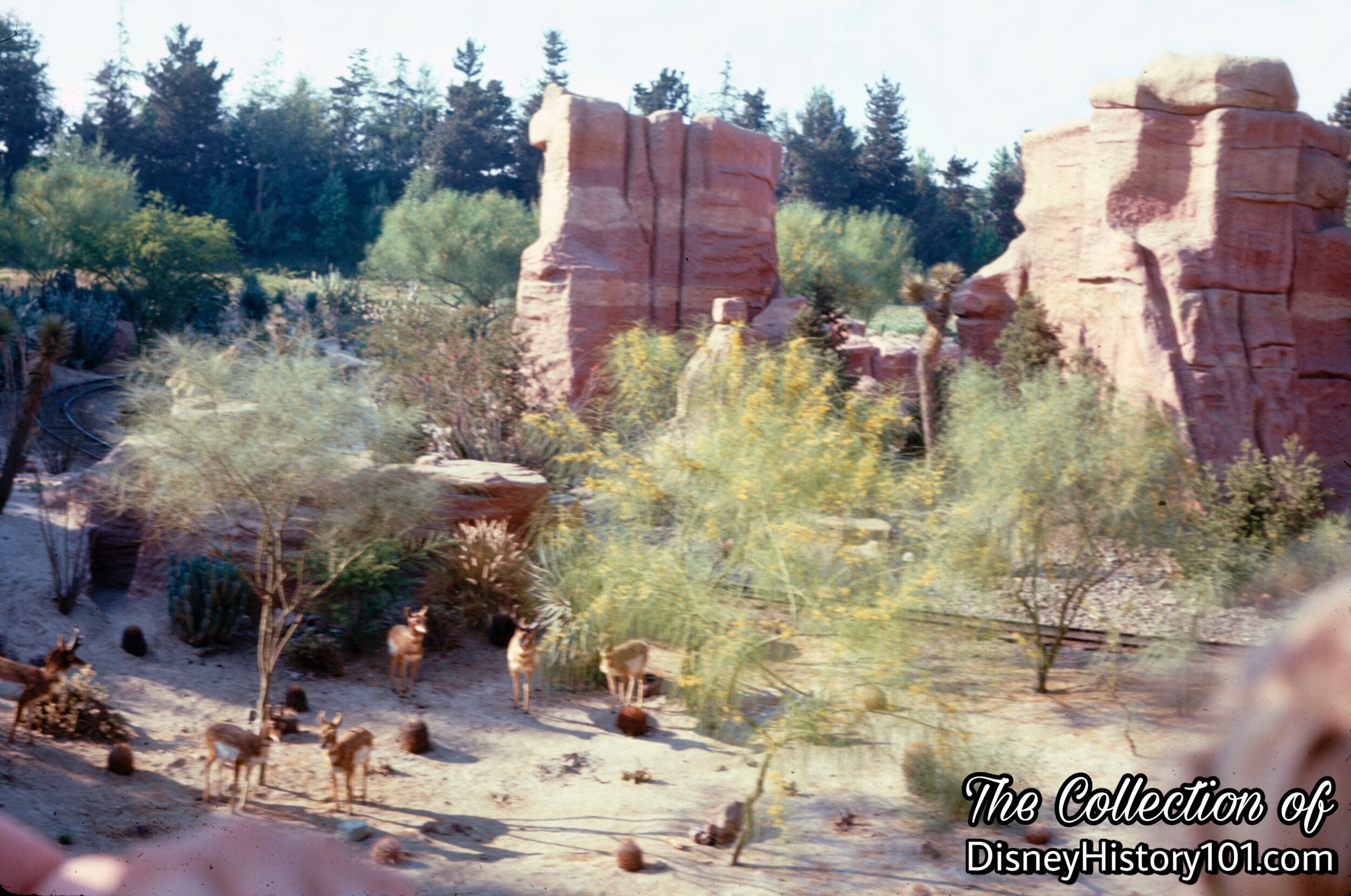
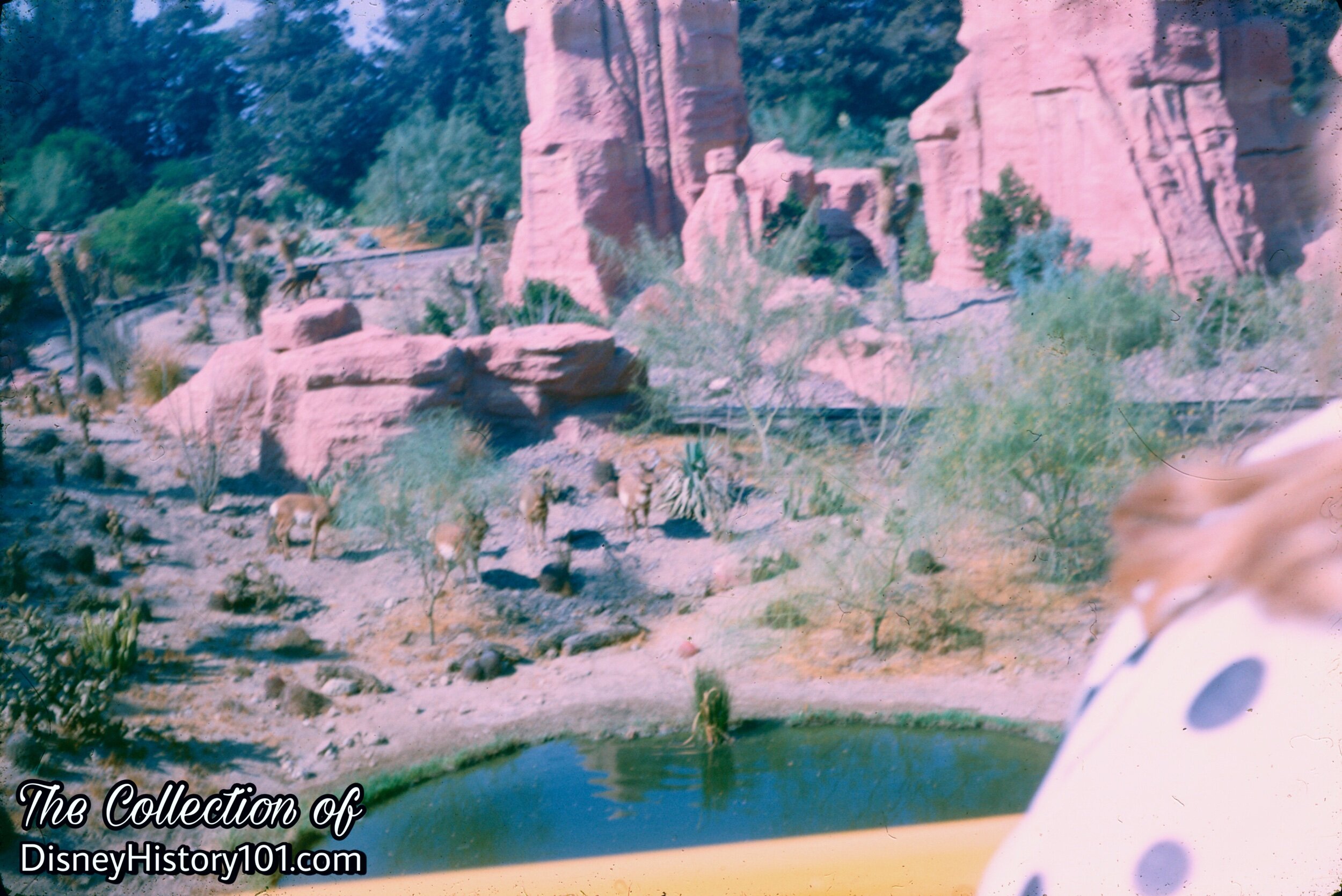
Y’know, the desert’s a dry place, and full of some pretty mean varmints. It looks as if a herd of Pronghorn Antelope have made their way toward Desert Pond - a water source in the Living Desert! But, they’re being followed.
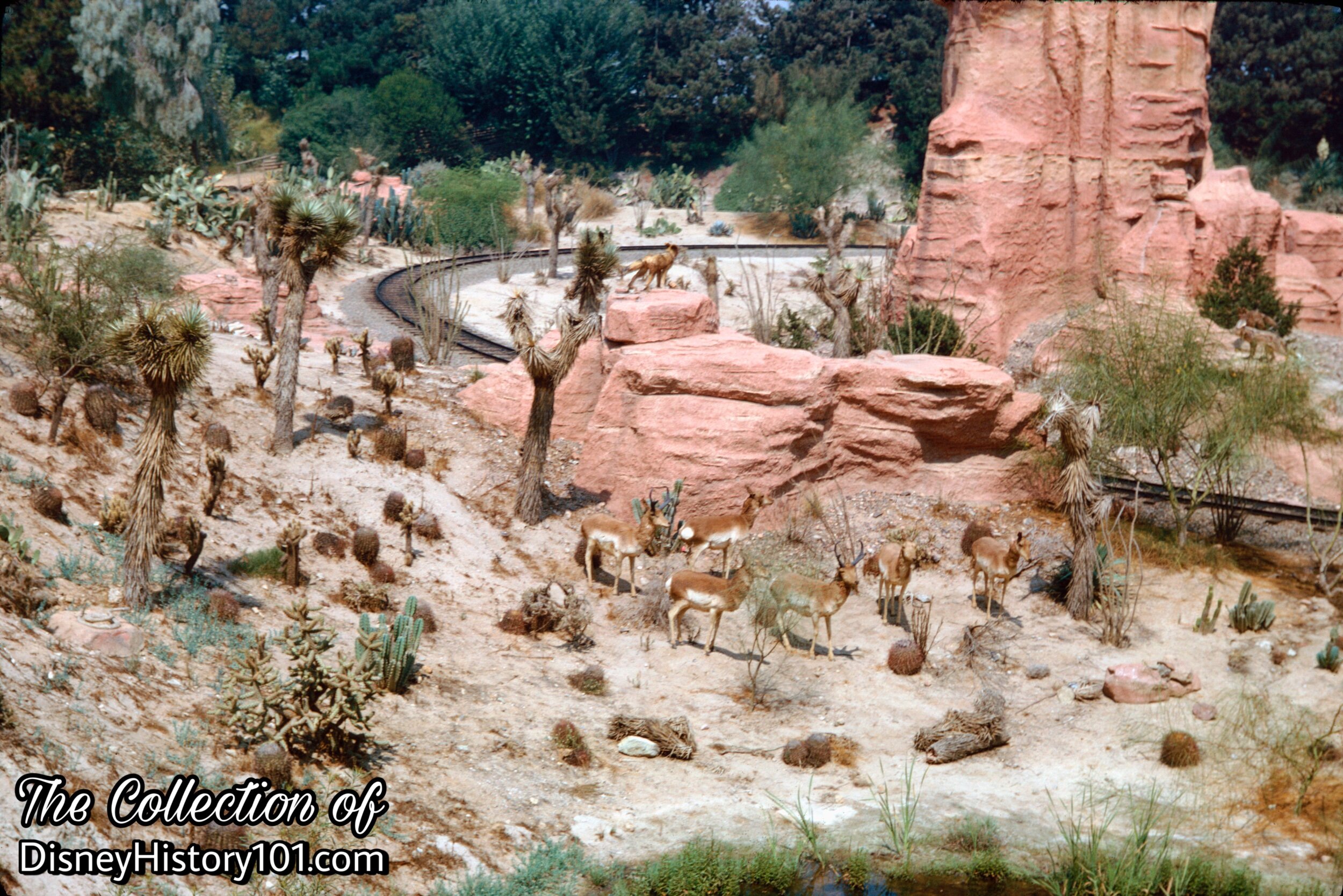

“But the desert’s got her beauty too! The yeller streaks runnin’ through them sandstone cliffs are called Coconino. The red we call them supai.”

“A Living Desert must, in truth, appear as a living desert”, reads the forward of Disneyland World of Flowers (published 1965), by Morgan Evans. This area of the Painted Desert was modeled after the American Southwest with reddish rock, sandy plateaus, cactus, and Joshua Trees.
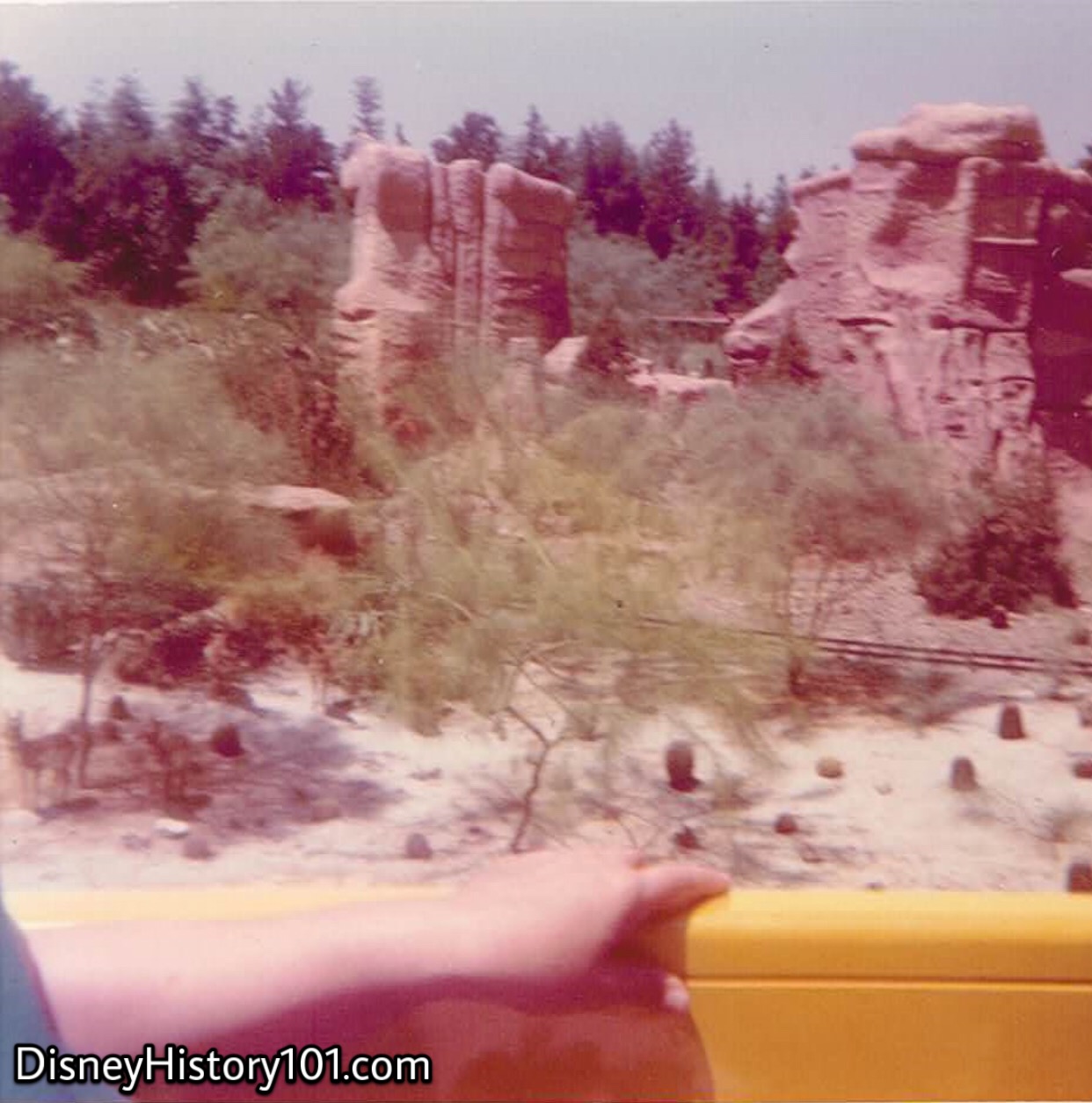
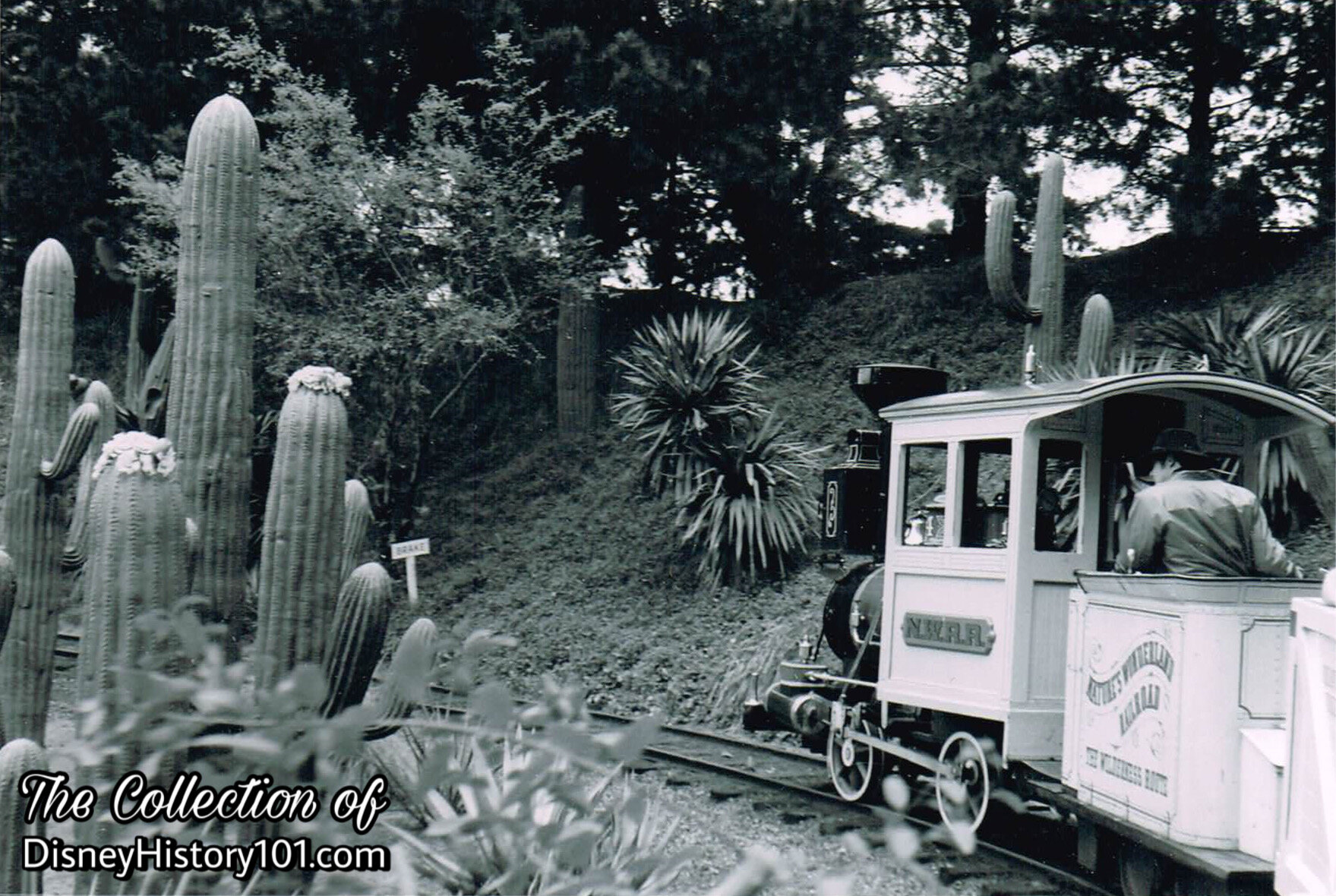
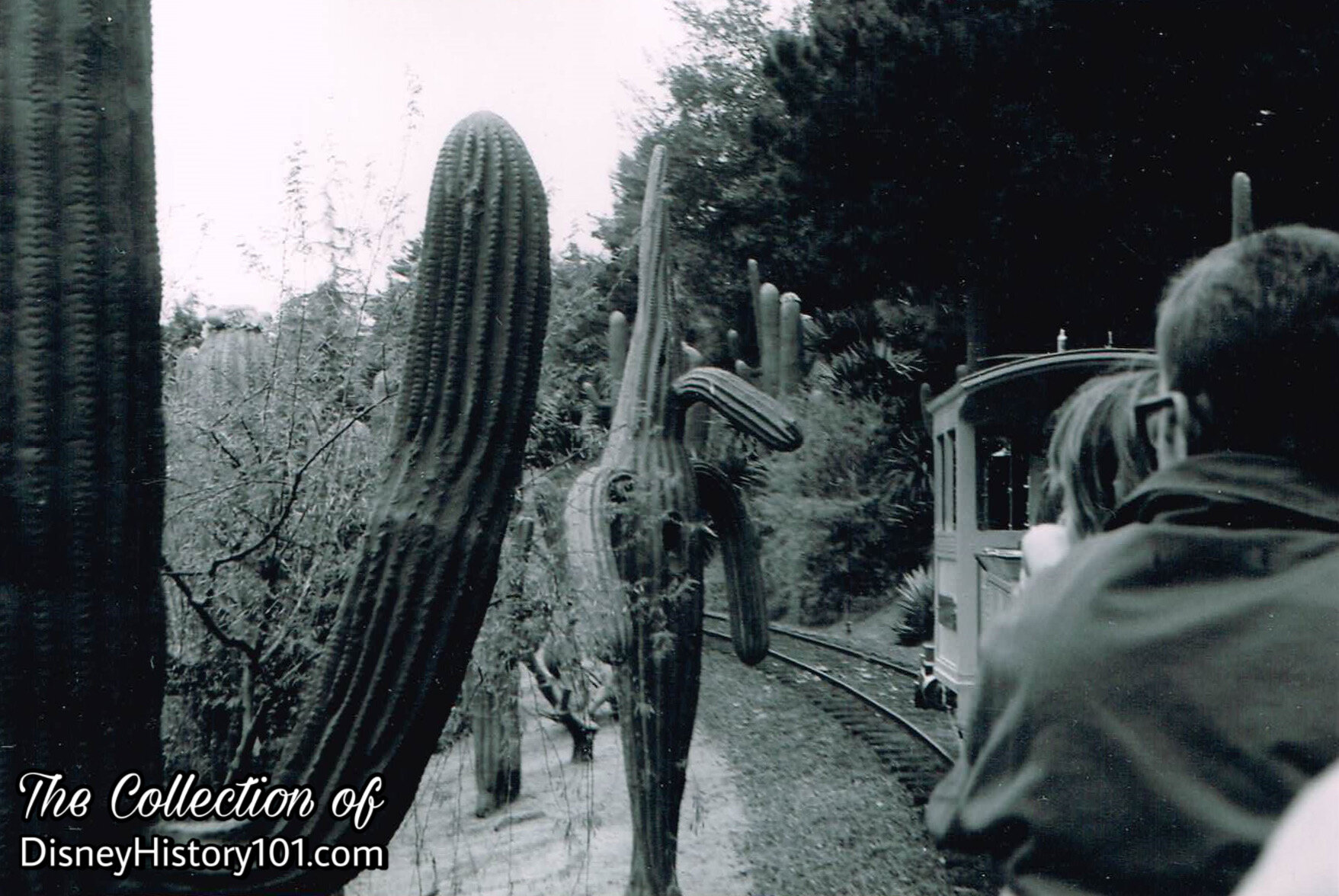
“The desert heat sometimes gets to ya, and makes these here cactus take on strange shapes like animals and sometimes even people.”
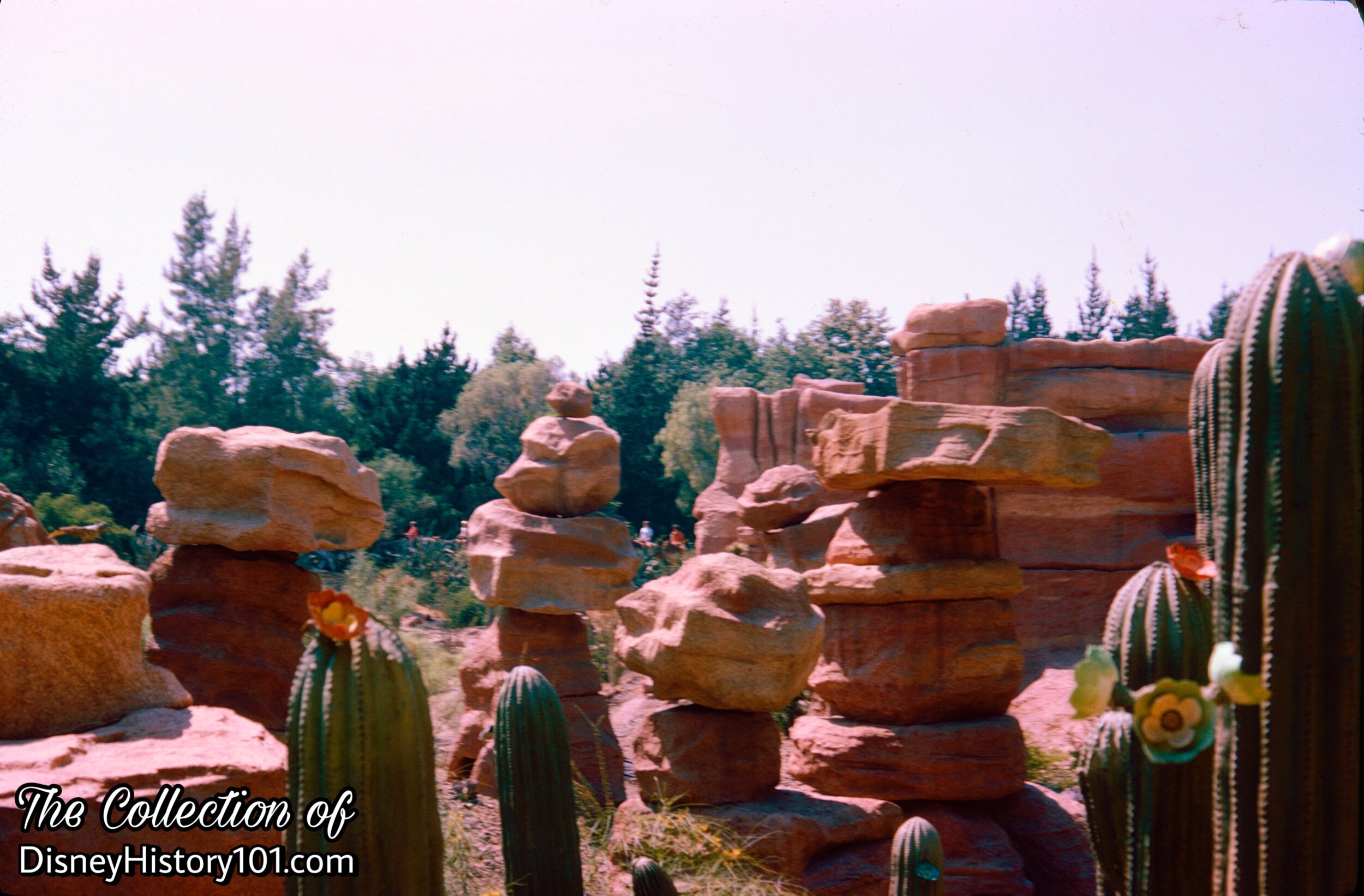
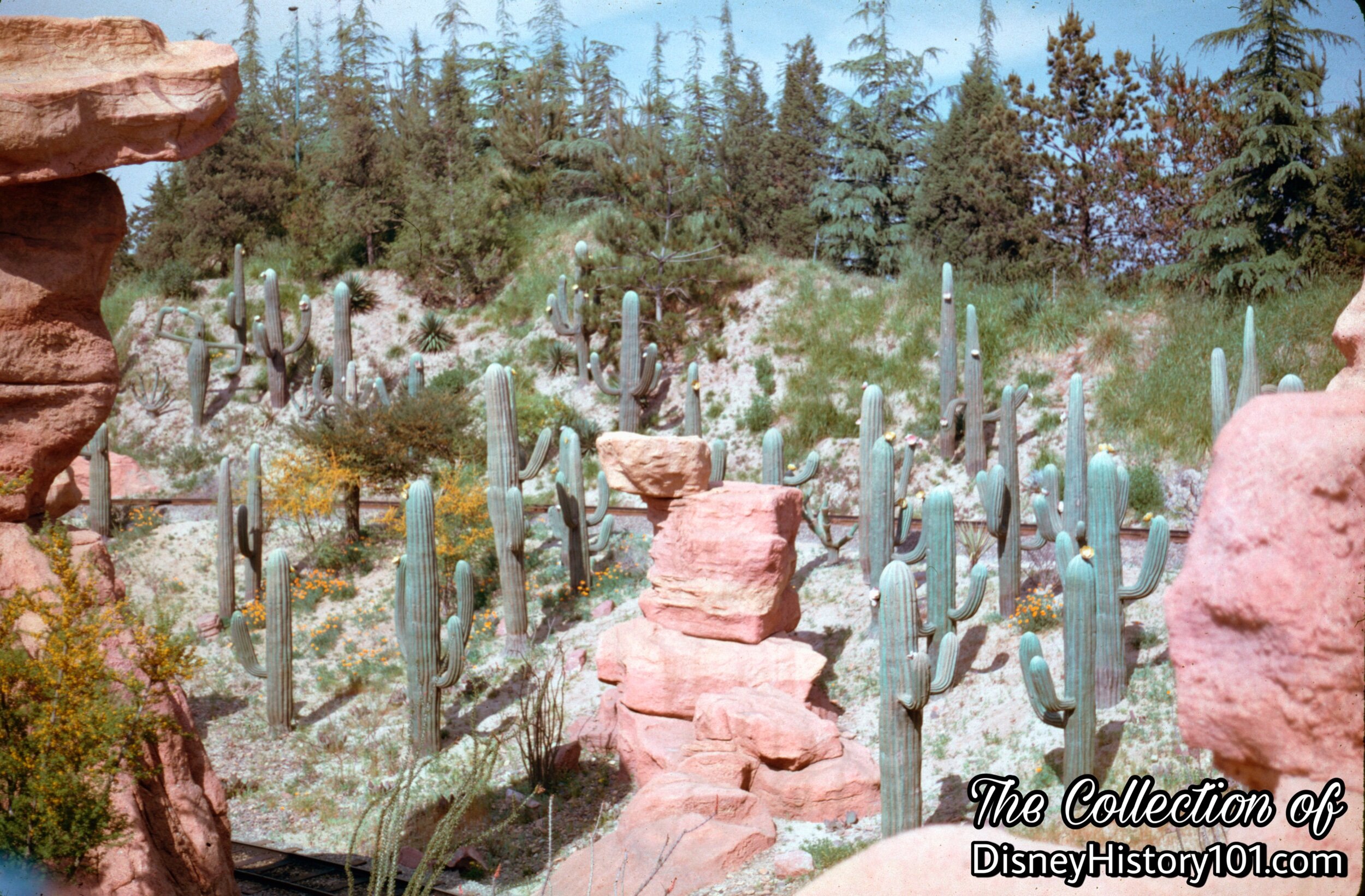
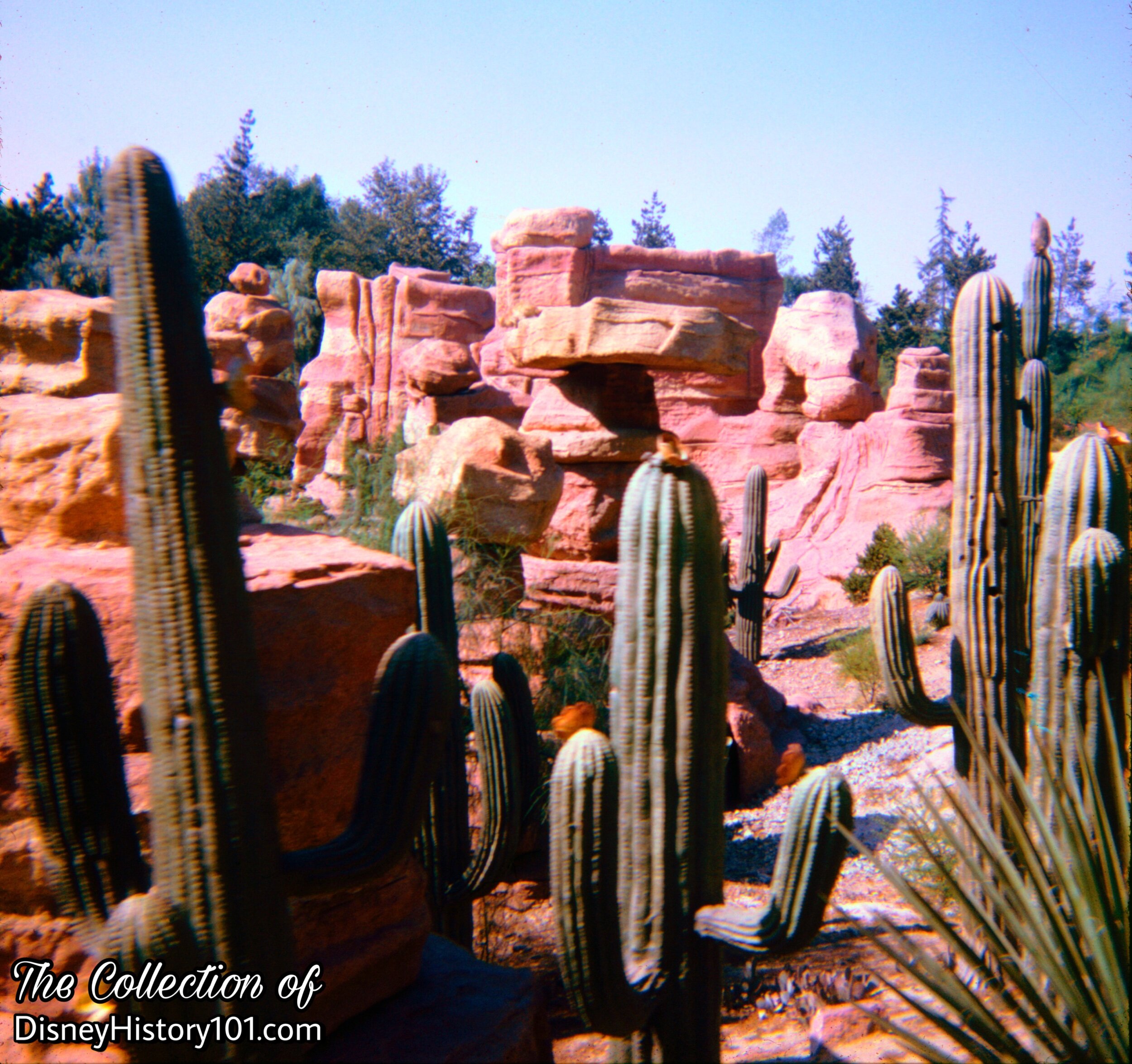
“Now ahead of us folks, is a Giant Saguaro Cactus Forest!”
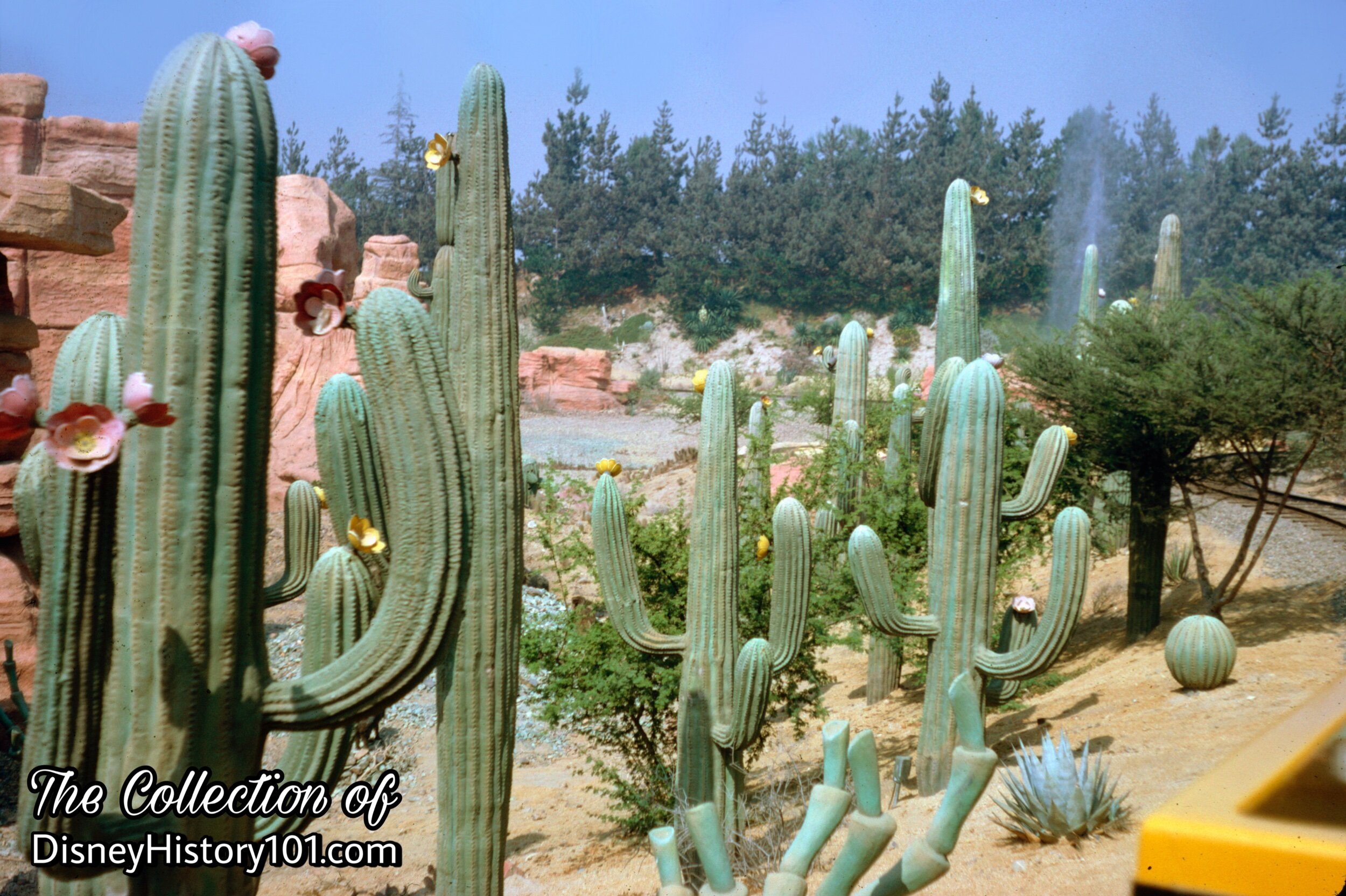
These colorful desert blooms stay fresh all year round!
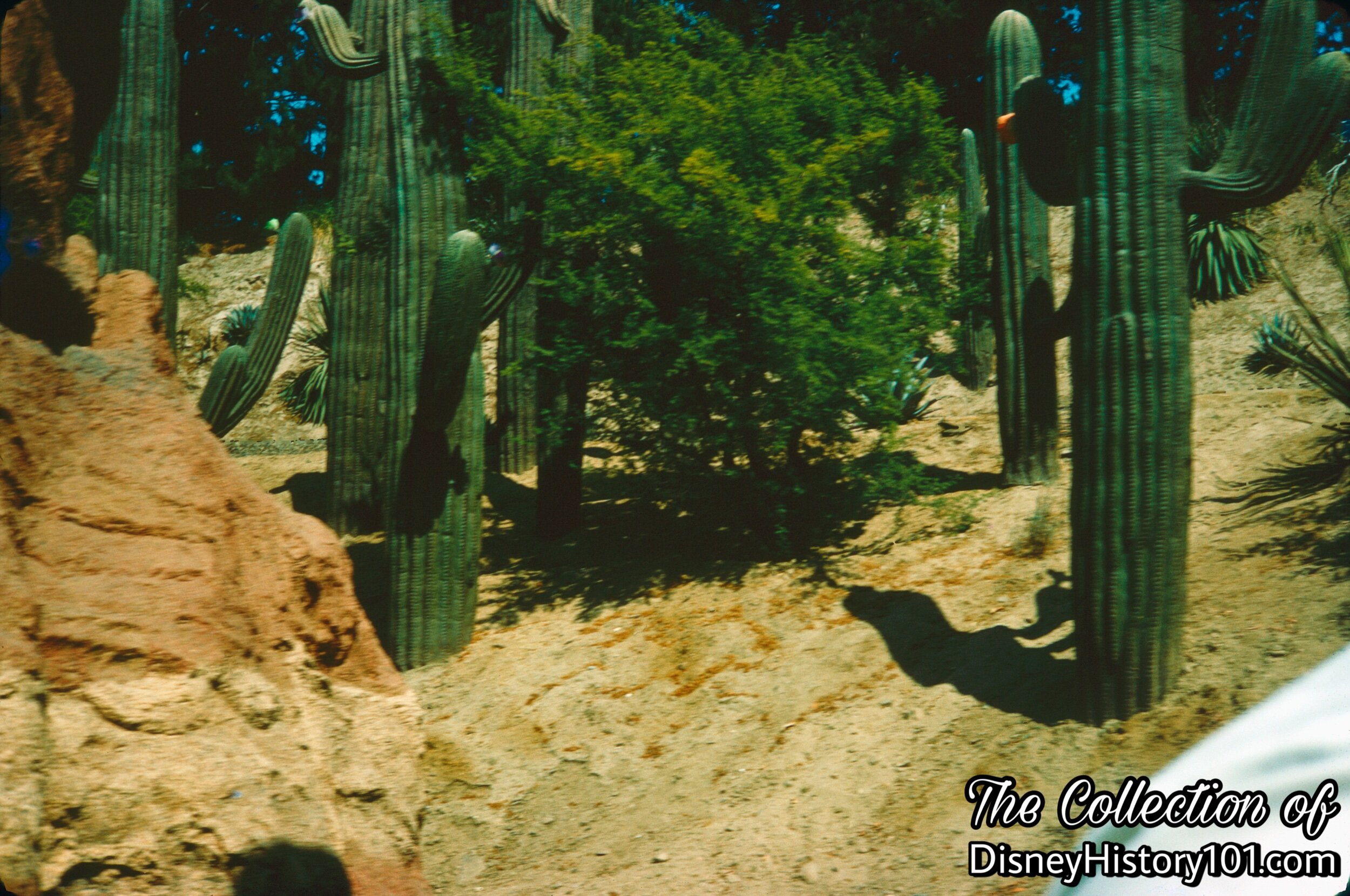
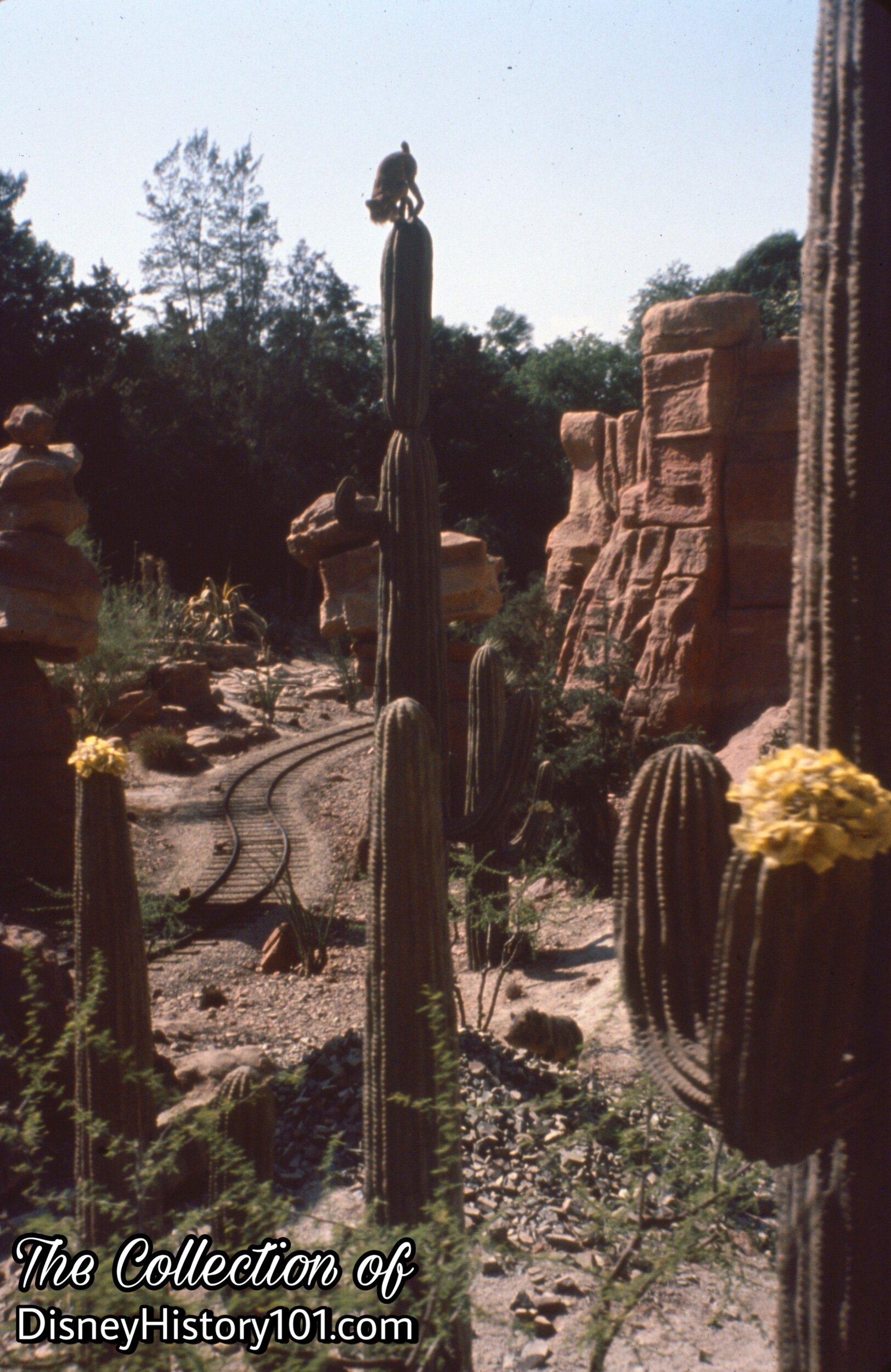
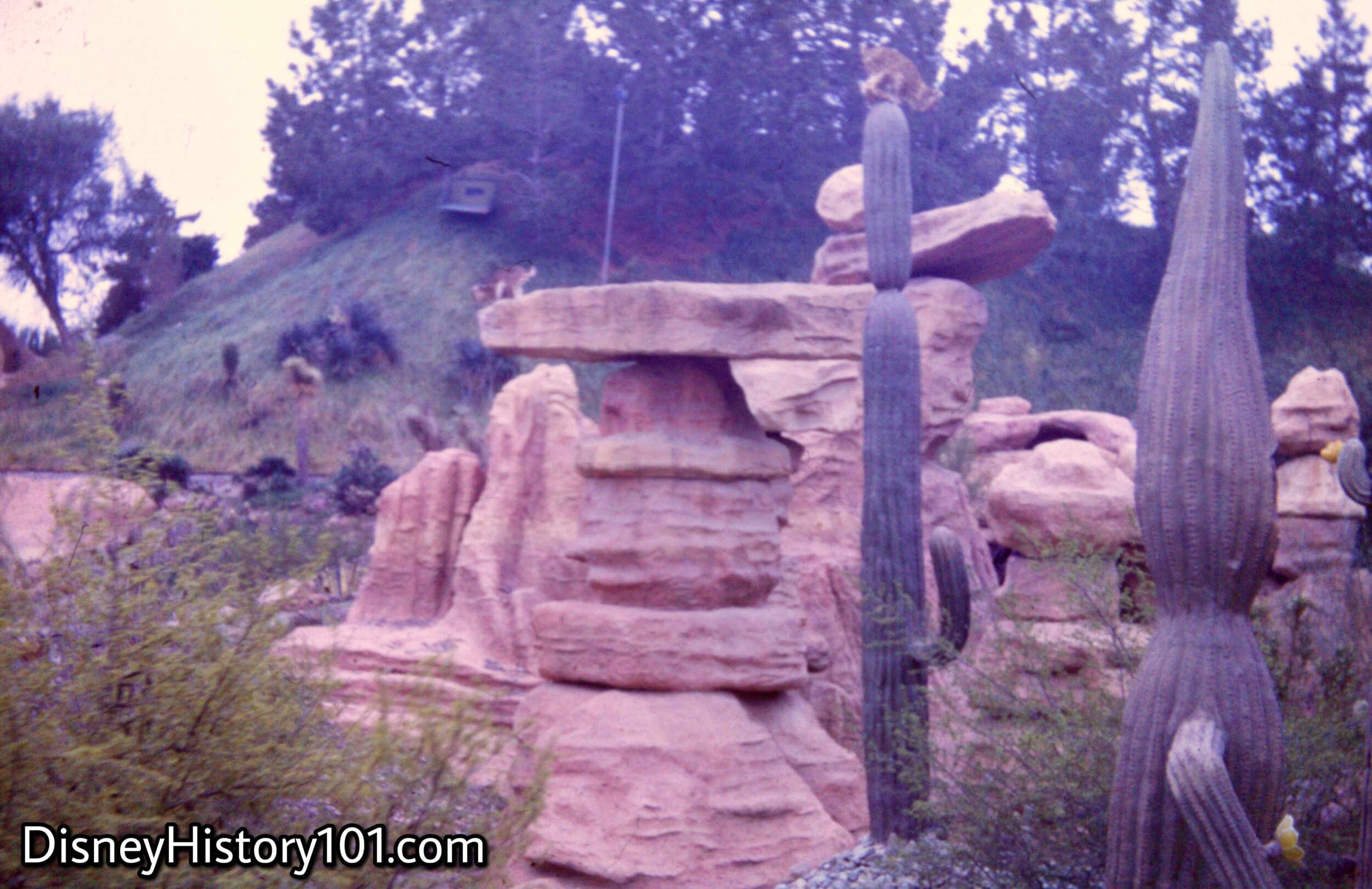
This scene of a tweed bobcat atop a cactus was taken from Walt Disney’s Academy Award-winning “The Living Desert”.
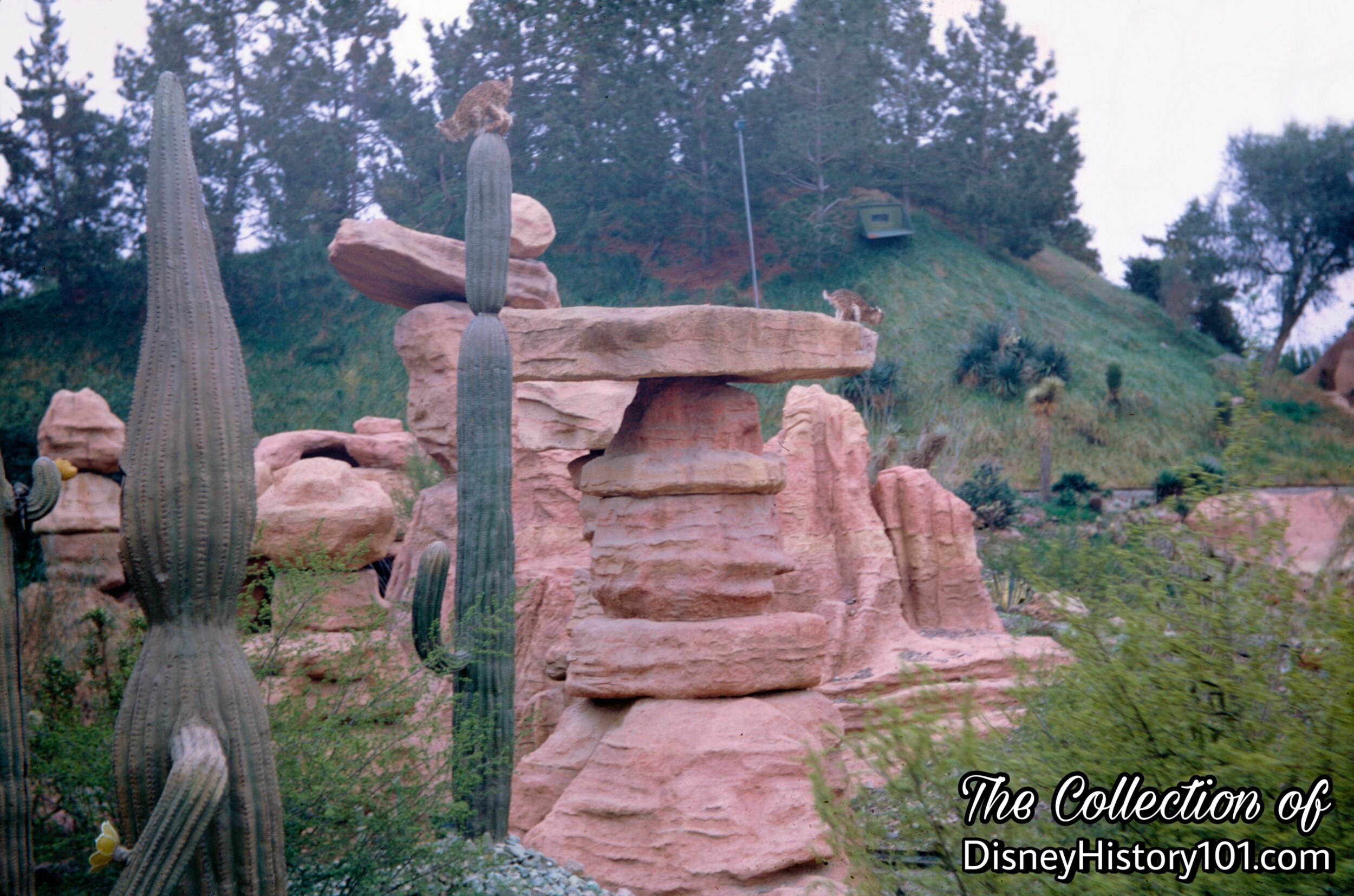
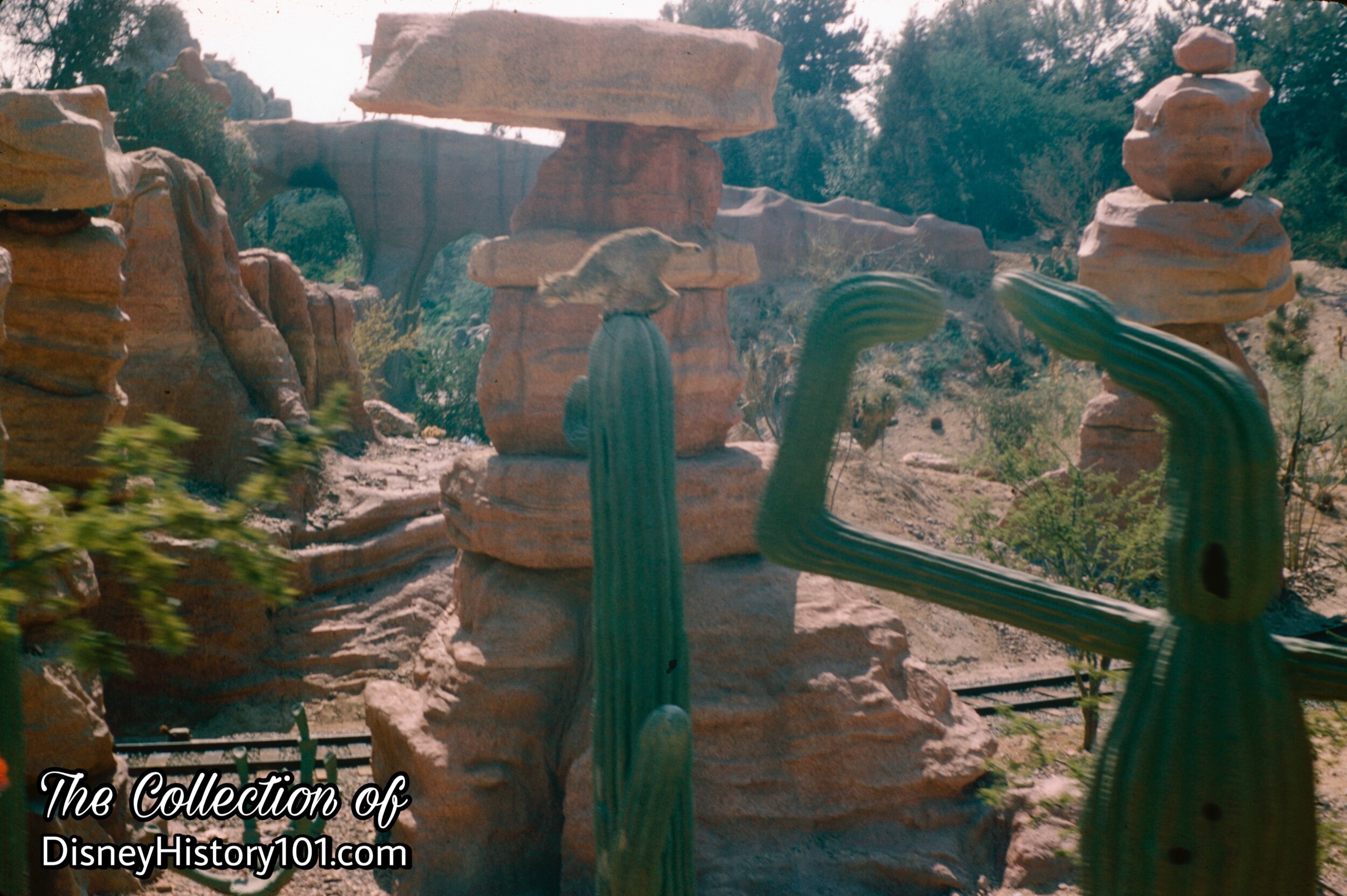
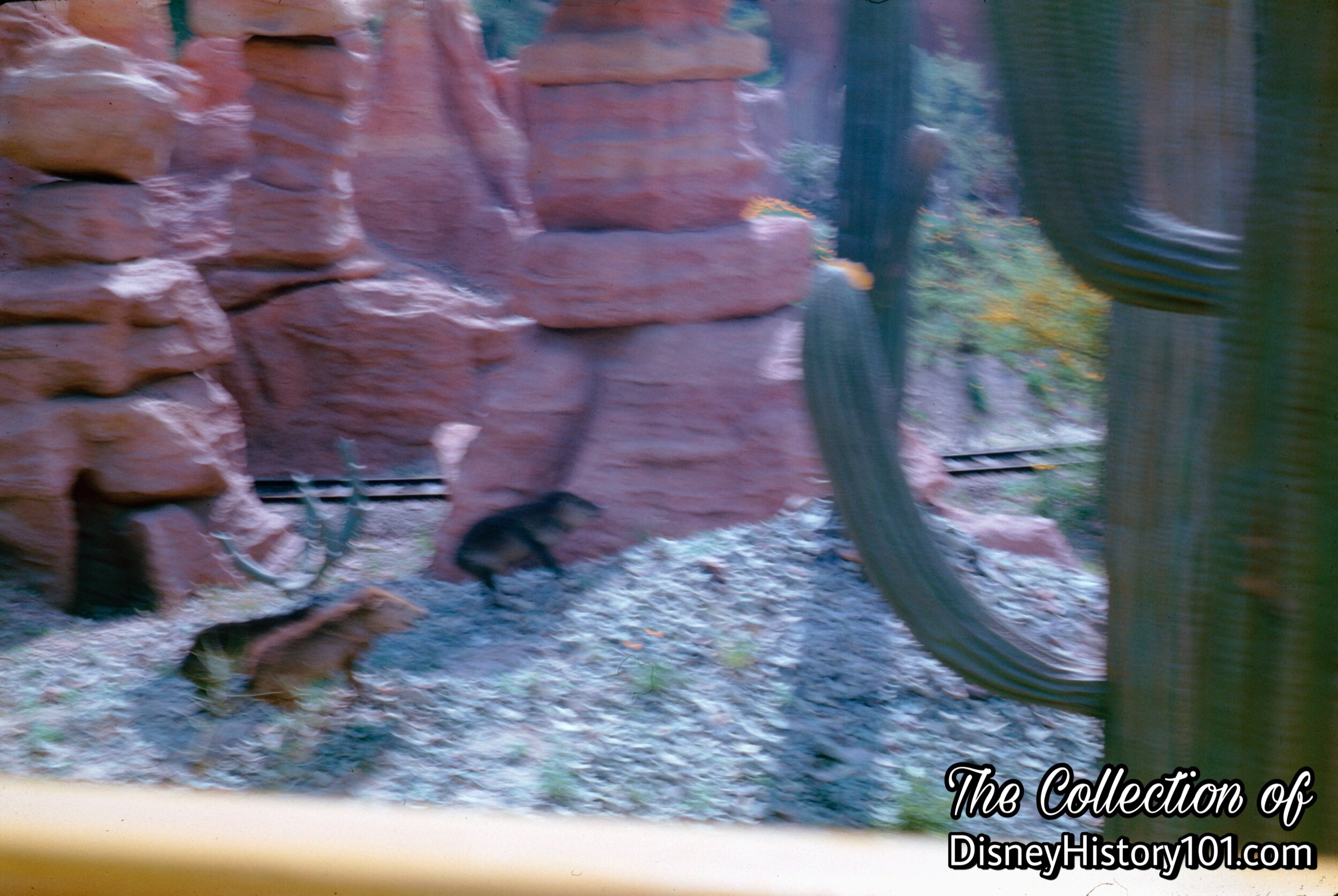
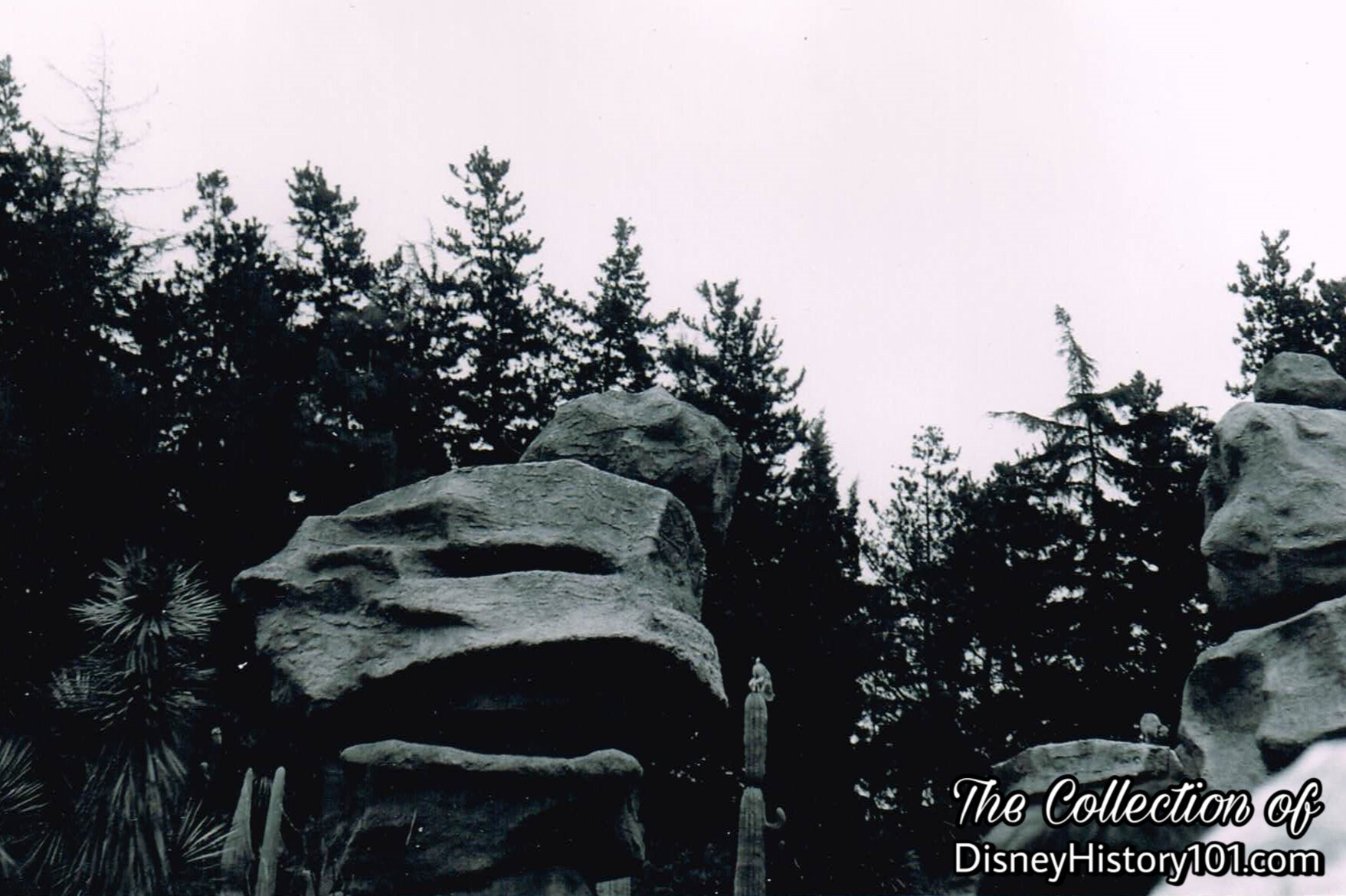

Geyser Country features four geysers (including Old Unfaithful) that operate from an underwater deep well pump that pressurized air and water.

“A Real Mystery of the Desert”
“Say, ever hear of the Devil’s Paintpots? (You can see them off in the distance there.) REAL mystery of the desert - bubblin’ pots o’ mud in all kinds o’ colors”, (unless you read Popular Mechanics of November, 1957)!
These thermal fissures appear to throw bubbling, steaming multicolored lava up through the crust, only to be caught in cauldrons of yellow, rust, and blue, adding “a note of color” to the desert! According to conceptual artwork (published in Popular Mechanics, November of 1957), an underground air compressor sends air from a storage tank to a specially designed manifold (which releases varying amounts of air at intervals). It turned out that the actual device was much simpler - an air jet would release air into an submerged and inverted bucket. The large air bubble would become large enough, until it was ultimately released, creating this “real mystery of the desert”.
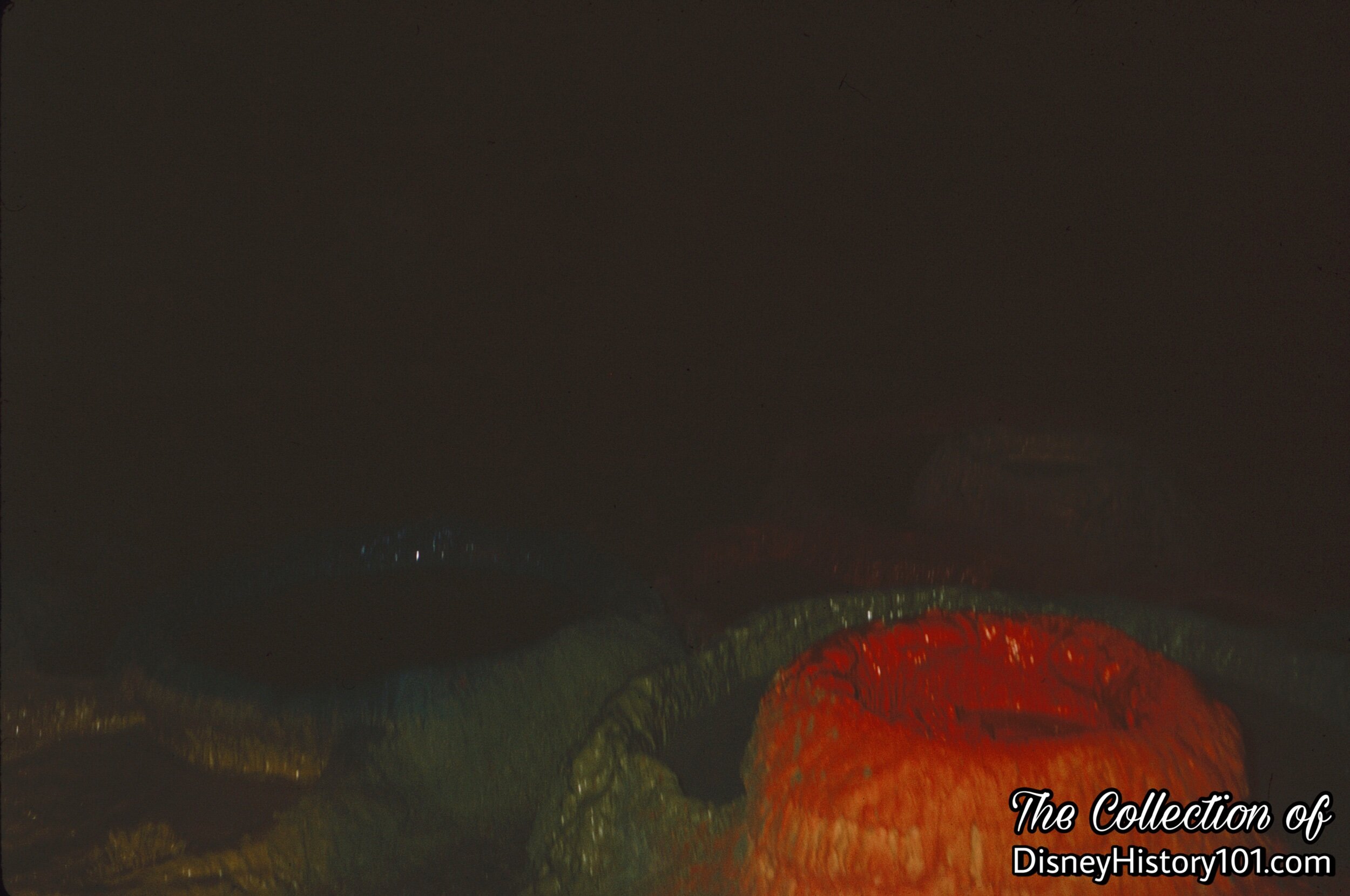
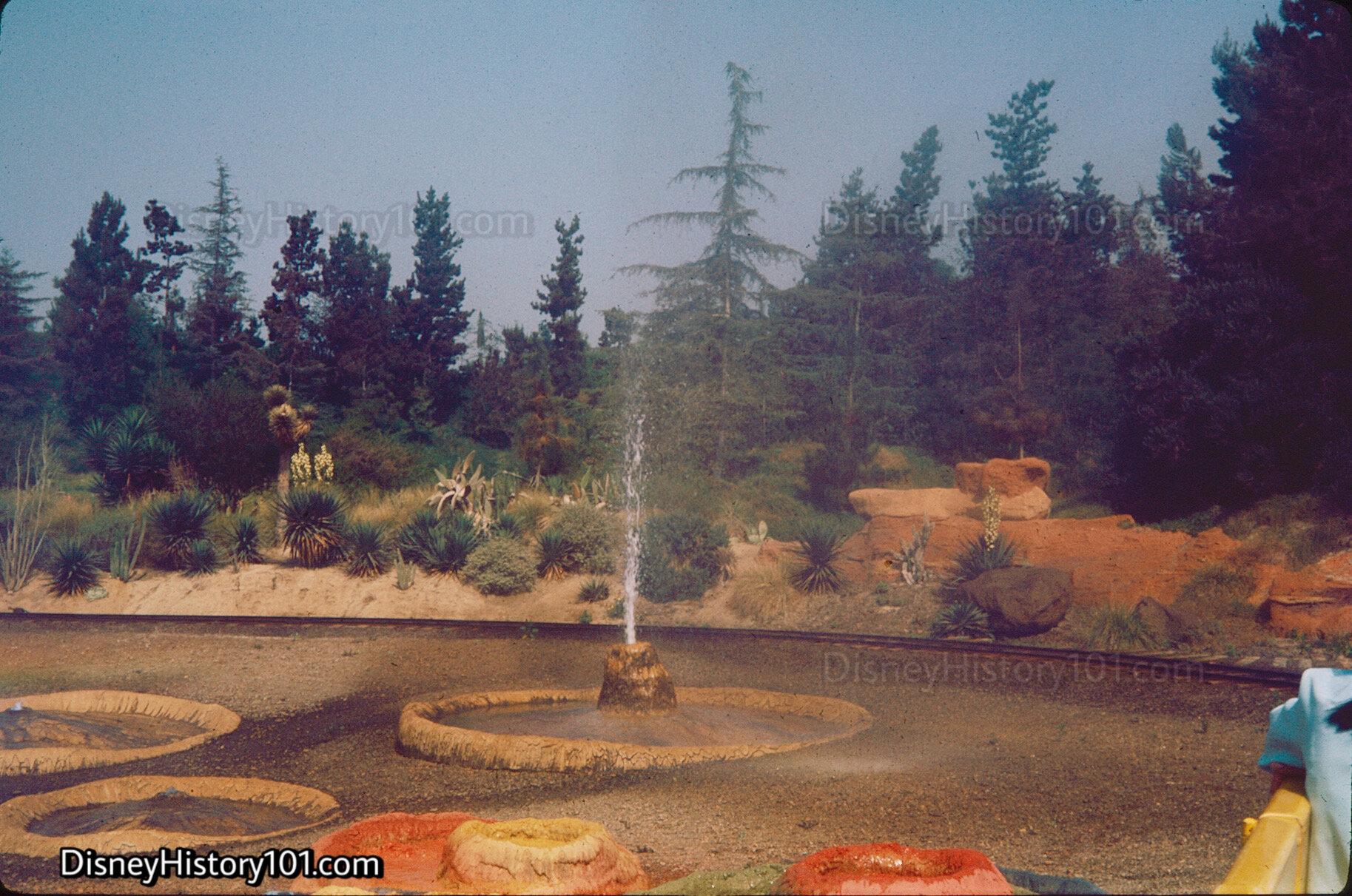
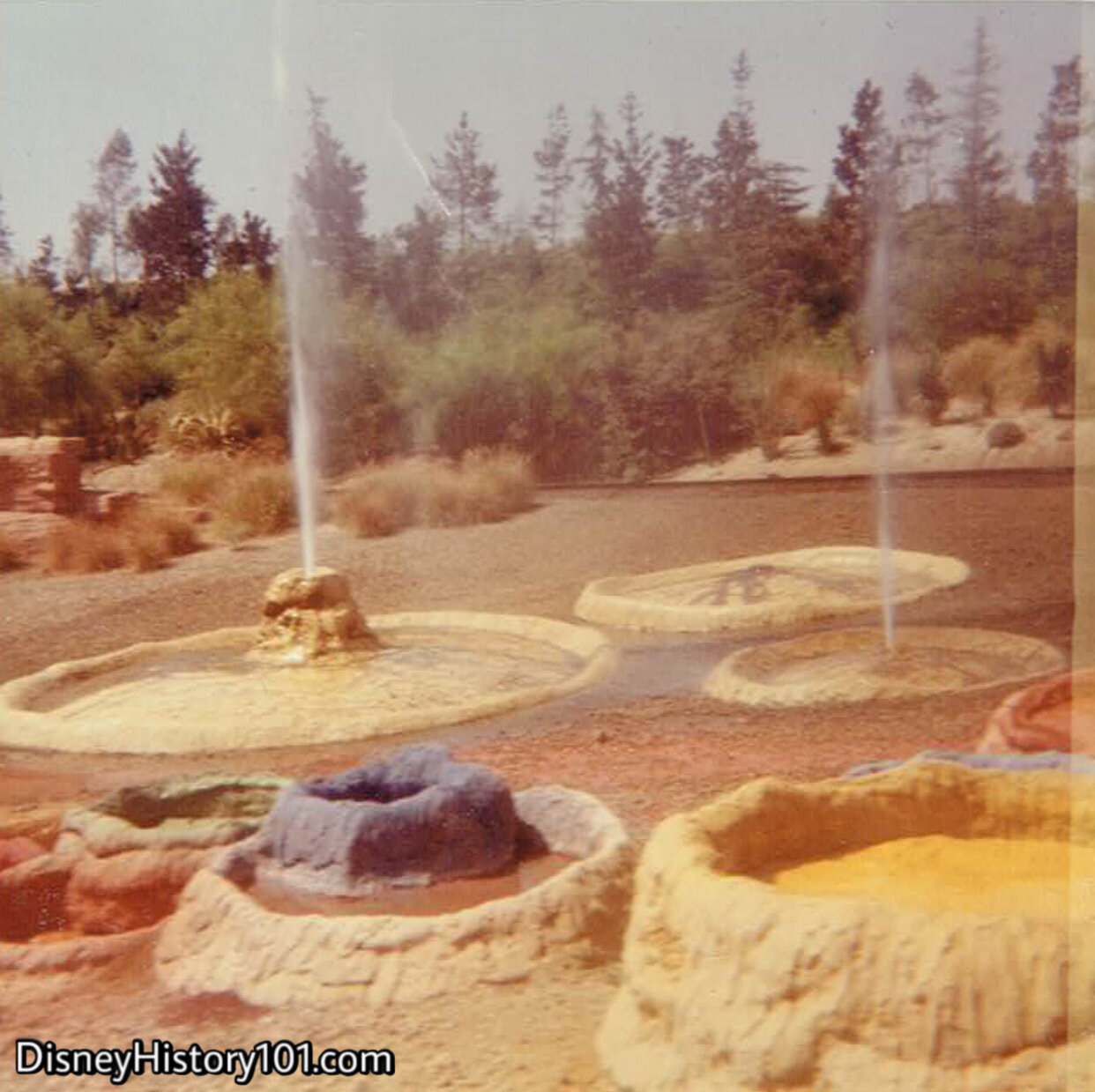
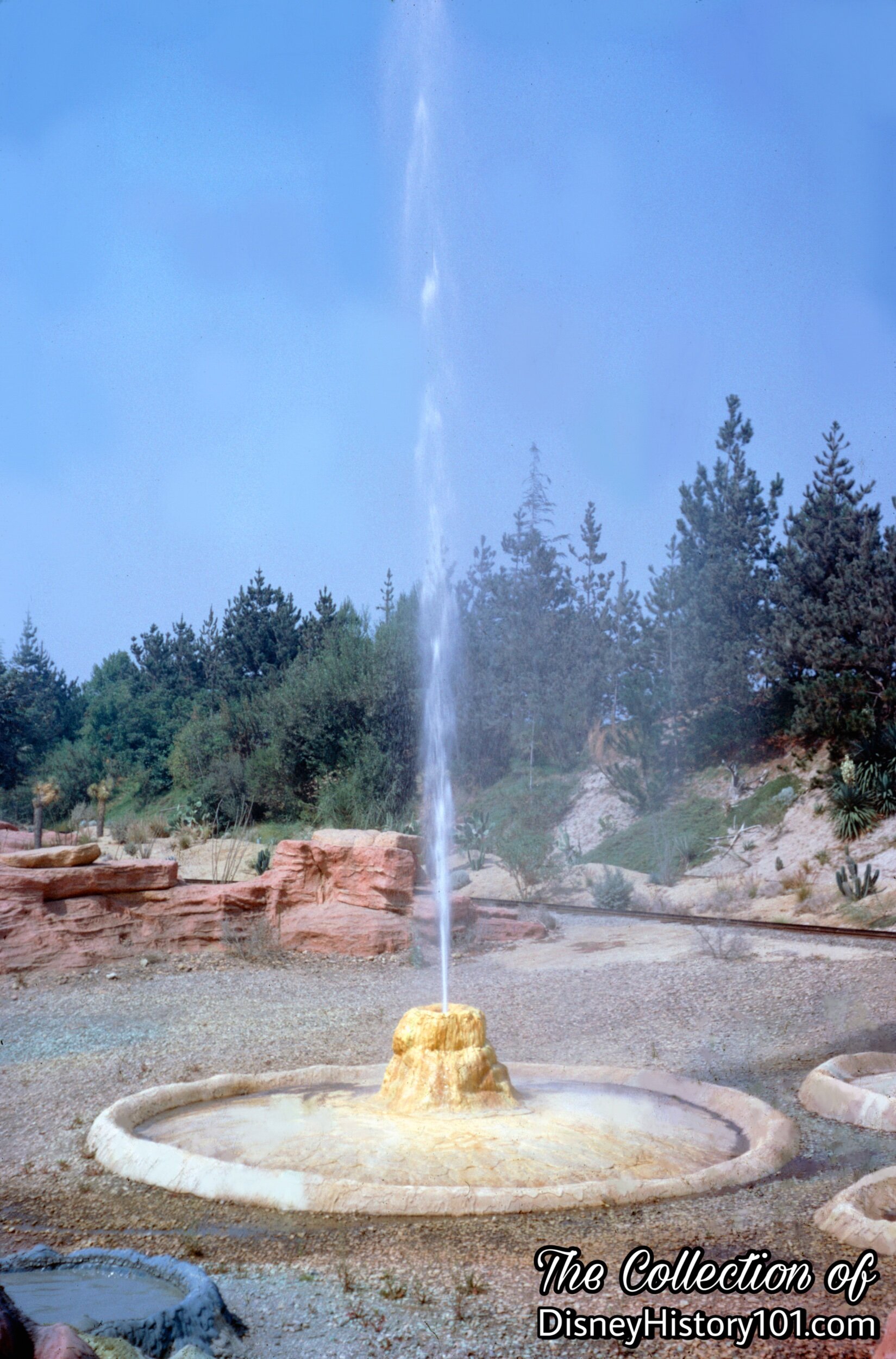
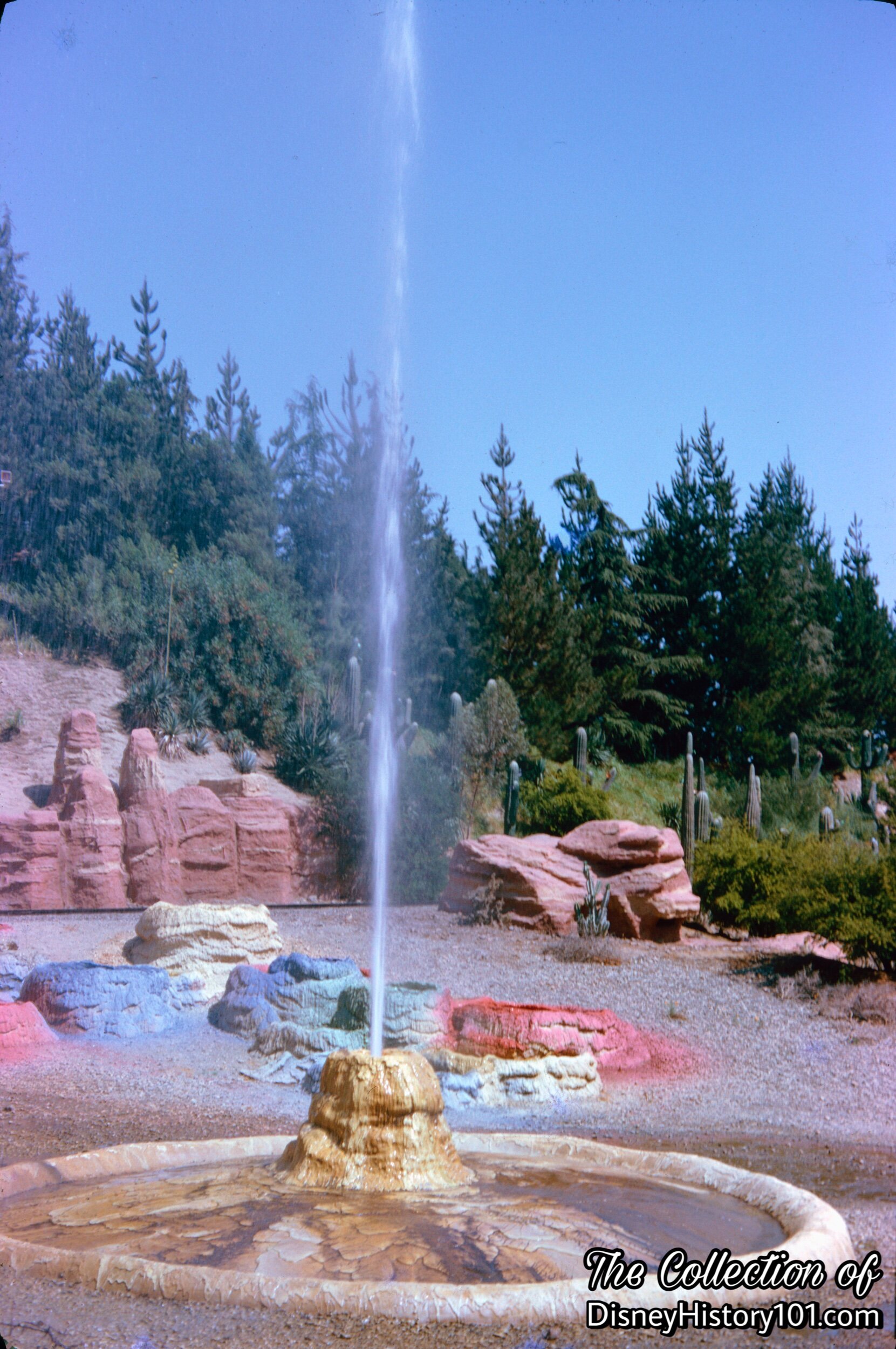
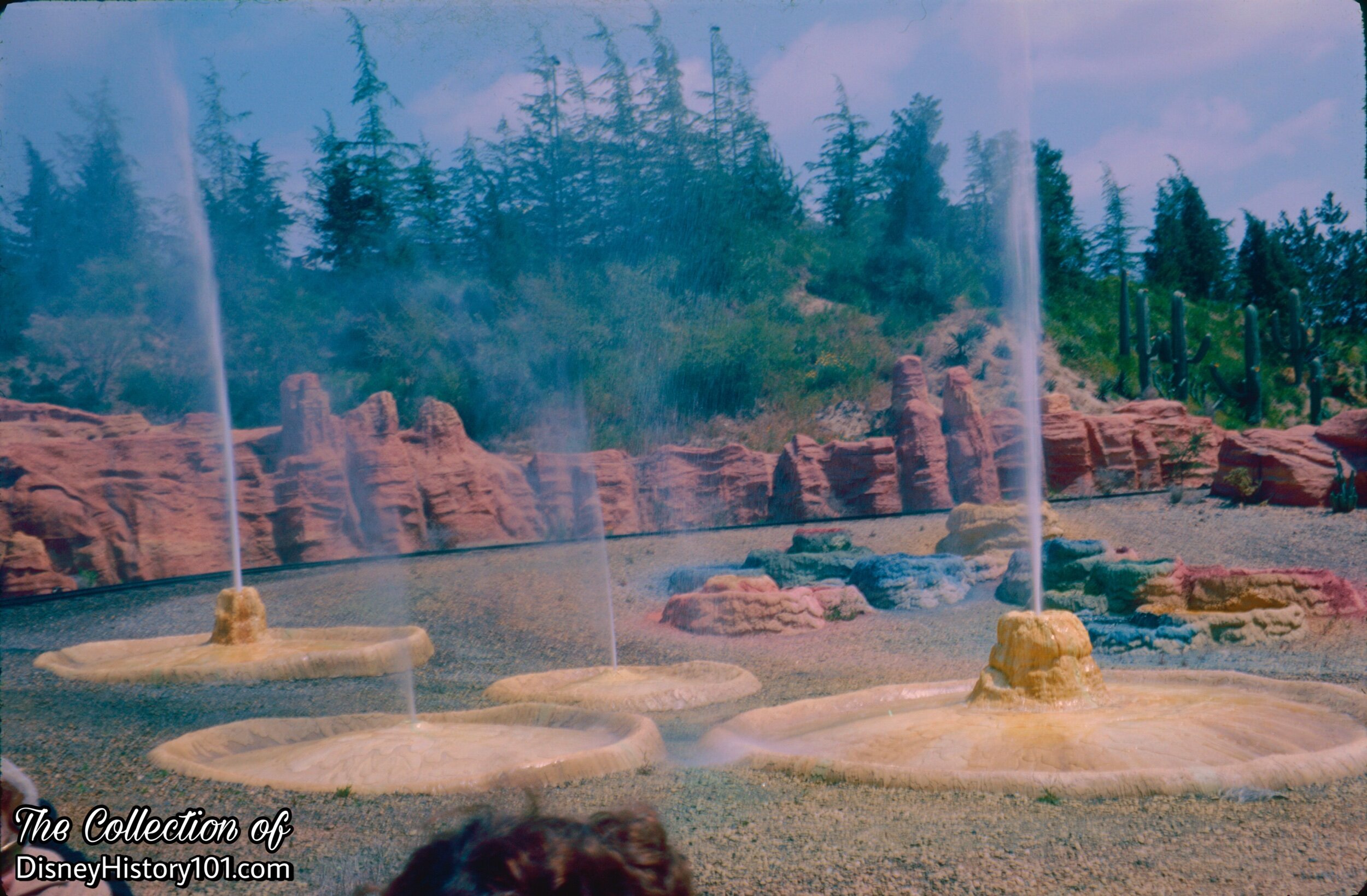
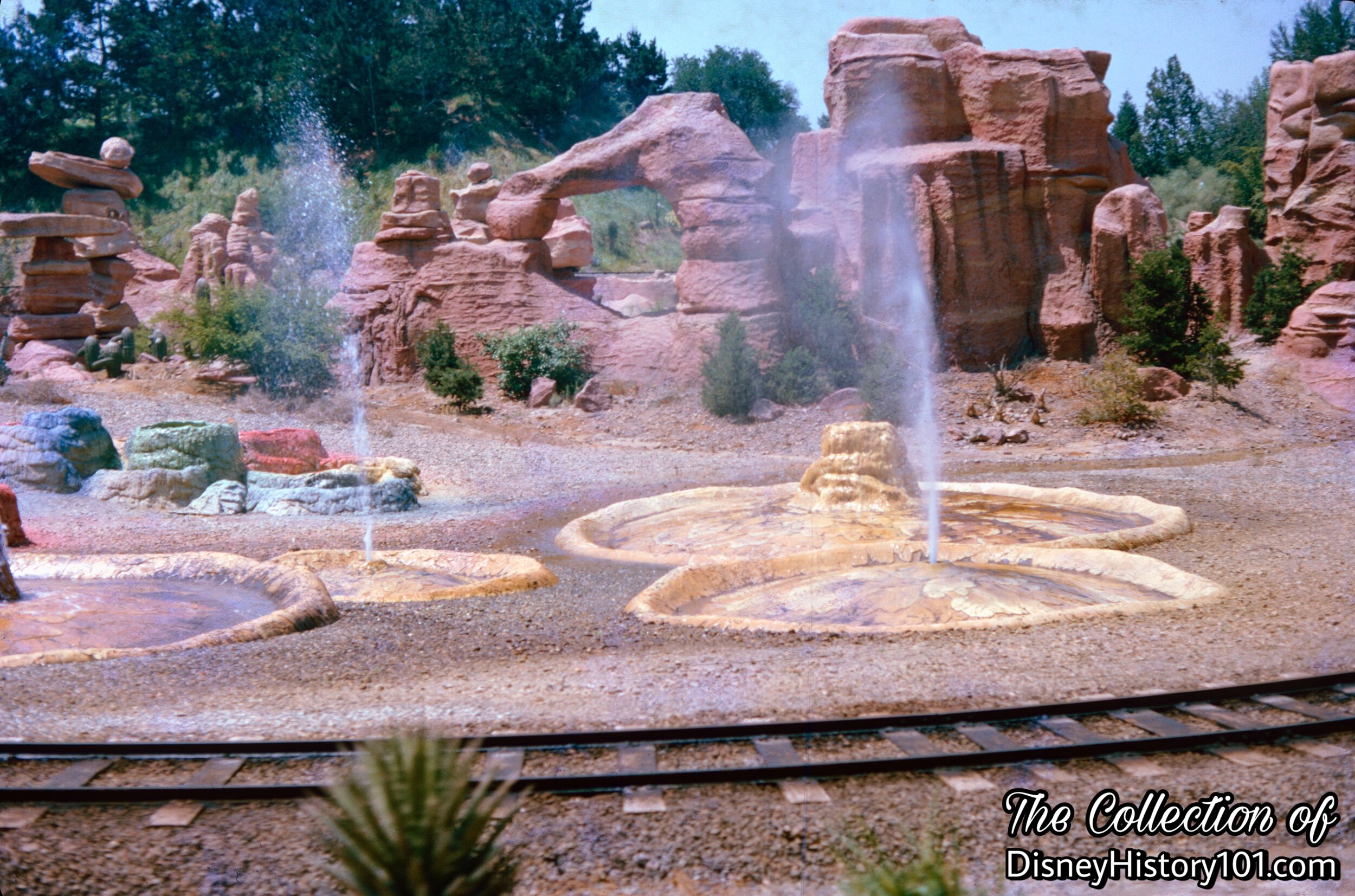
Geyser Country features four geysers (including Old Unfaithful) that operate from an underwater deep well pump that pressurized air and water.
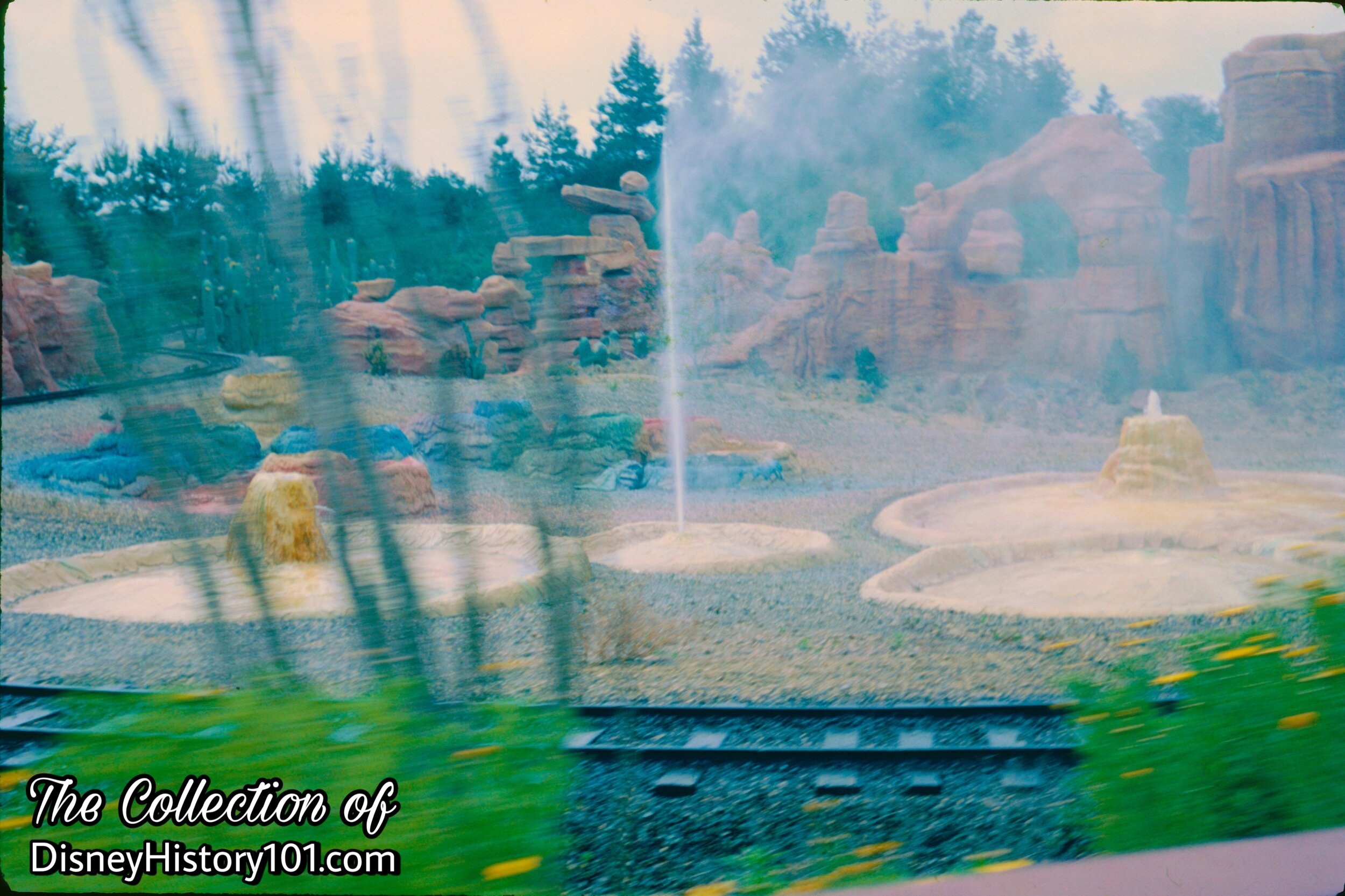
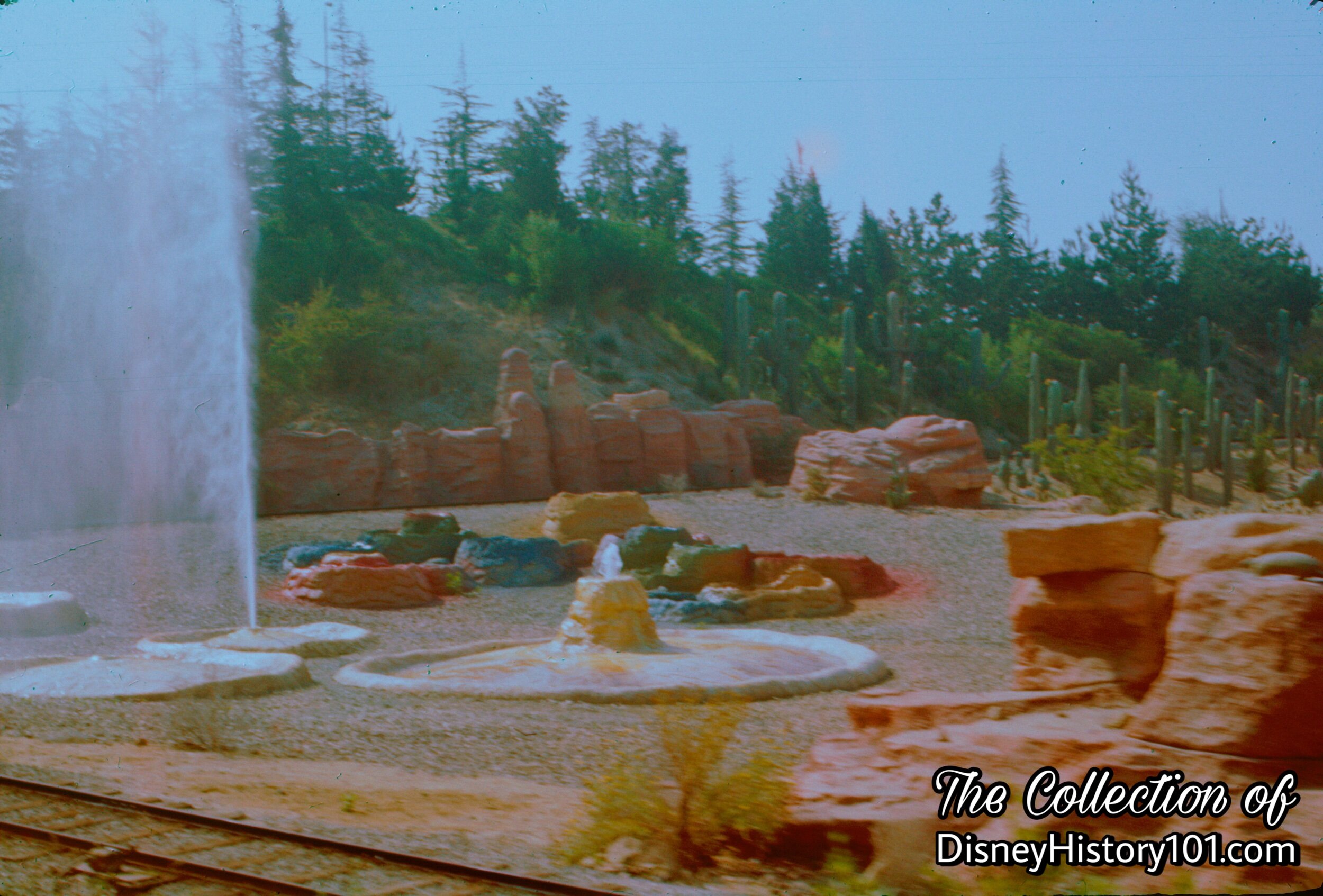
“This is ‘geyser country’ too. Uh, oh. ‘There she blows’. Sure glad ya all brought yer rain coats. But look out now. Ya never know when she’s gonna go off. That’s why they call ‘er “Ol’ Unfaithful. LOOK OUT NOW! You folks in them last cars be ready. She’s threatenin’ again.”
It looks as if the geyser’s subsiding from shooting 70-foot high streams of water into the air, giving us just enough time to escape!
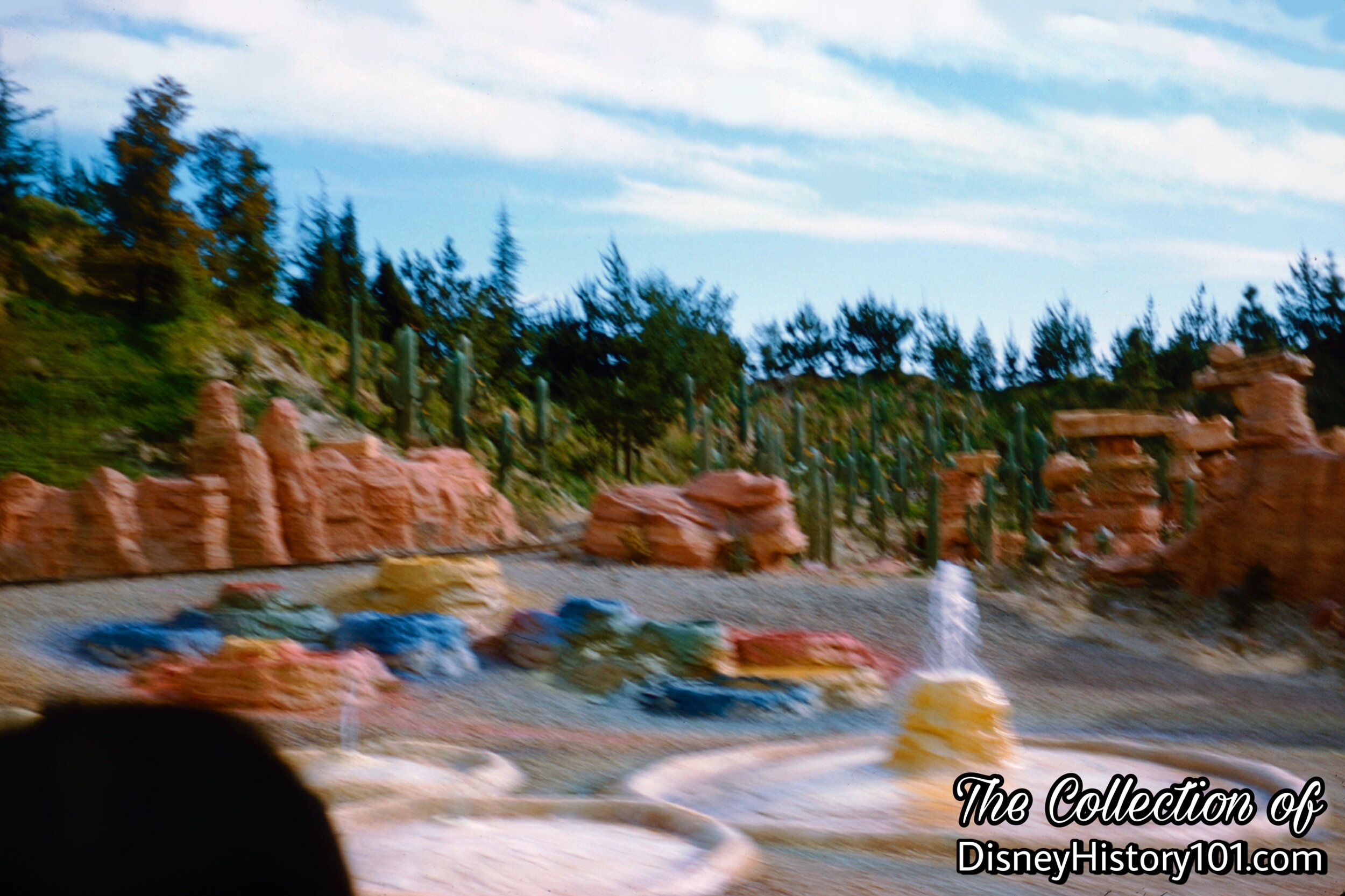
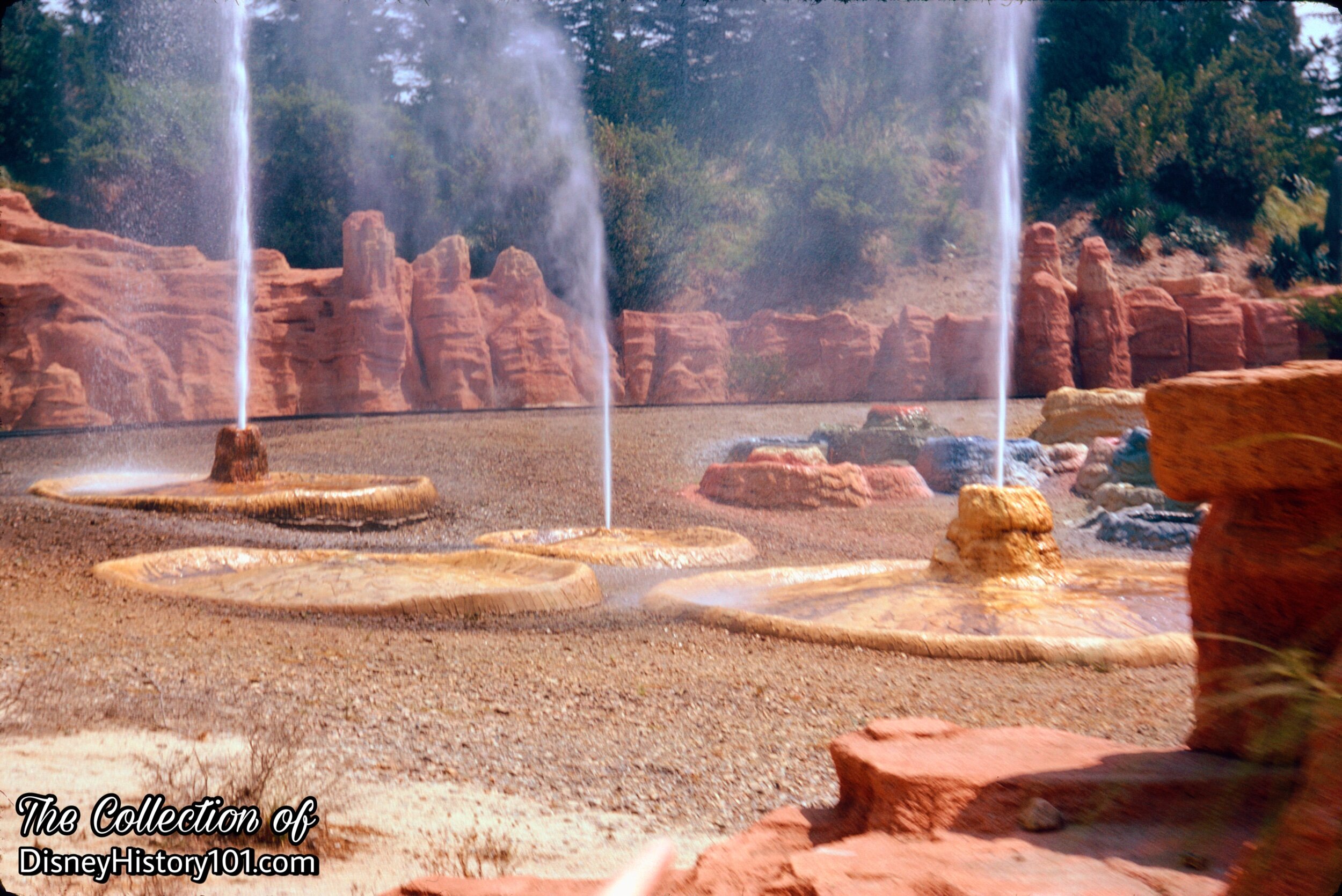
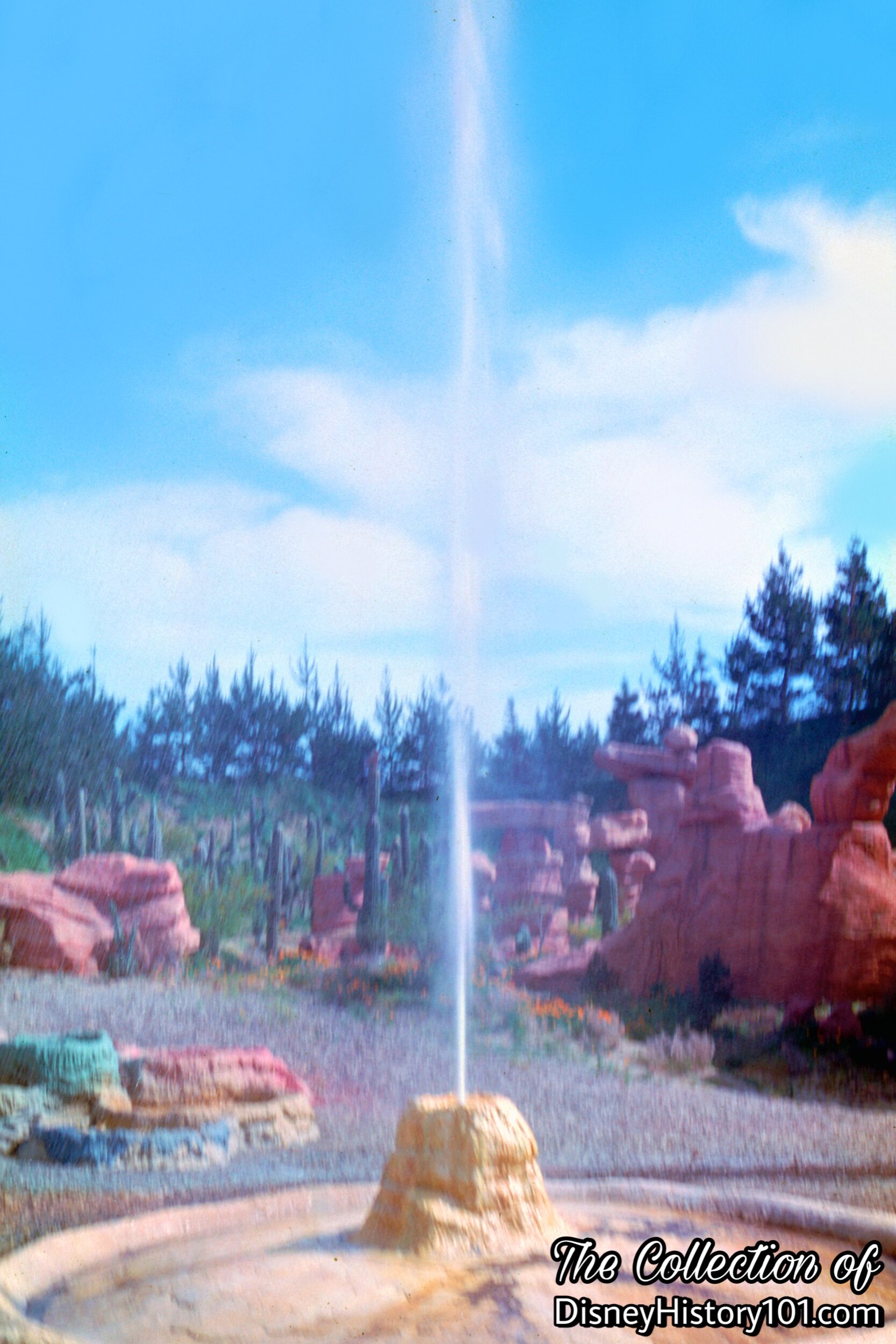
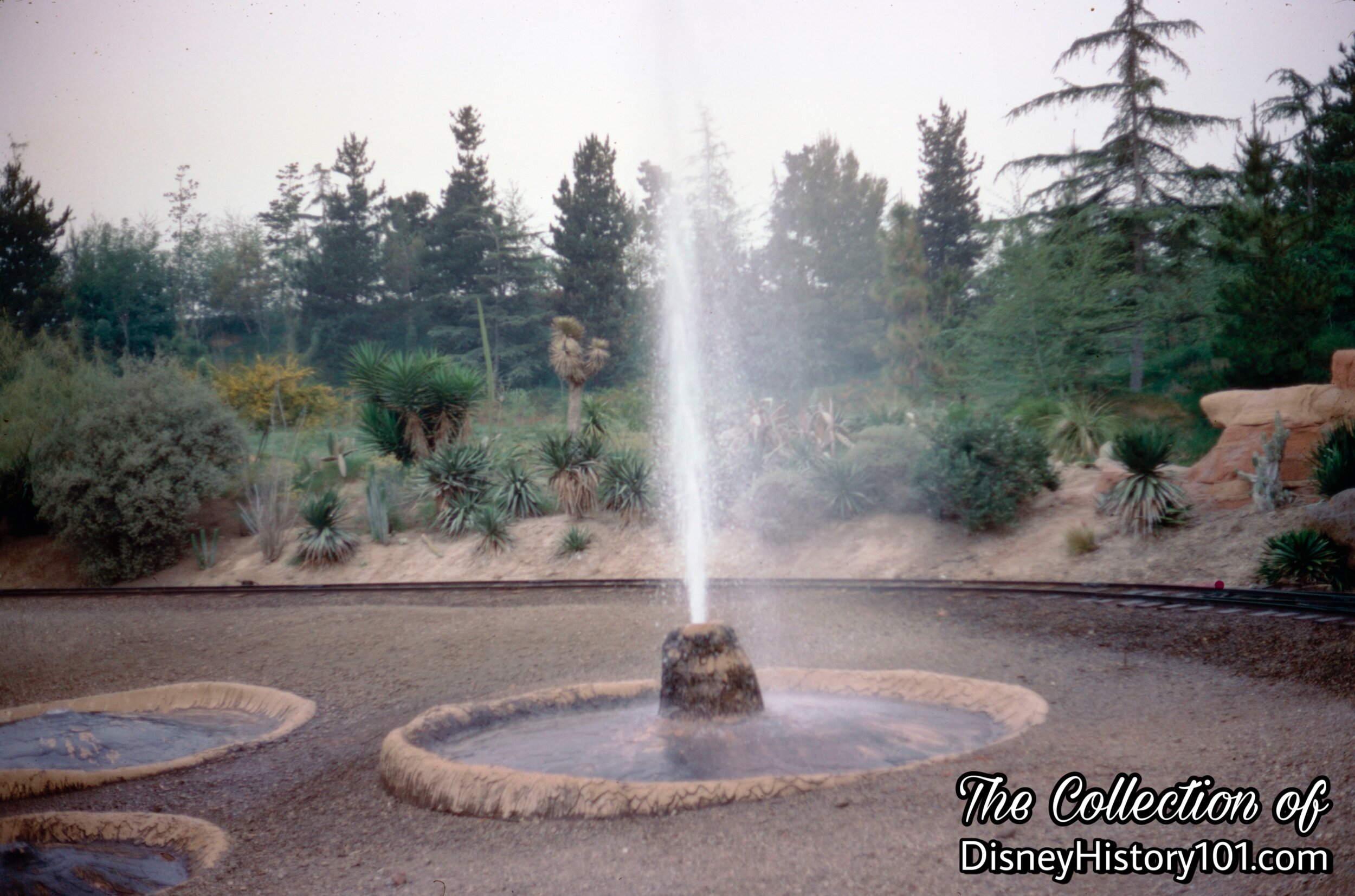
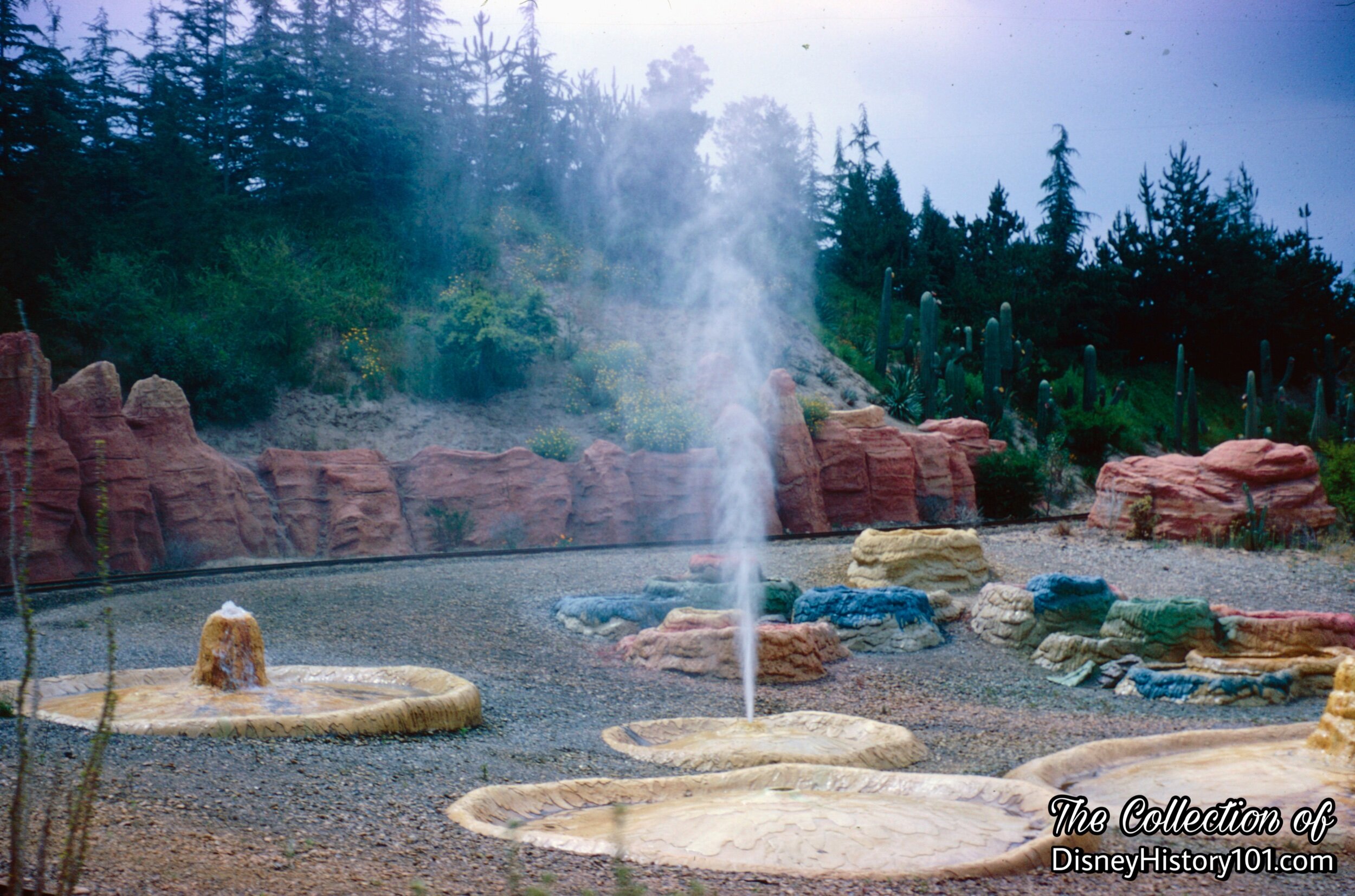
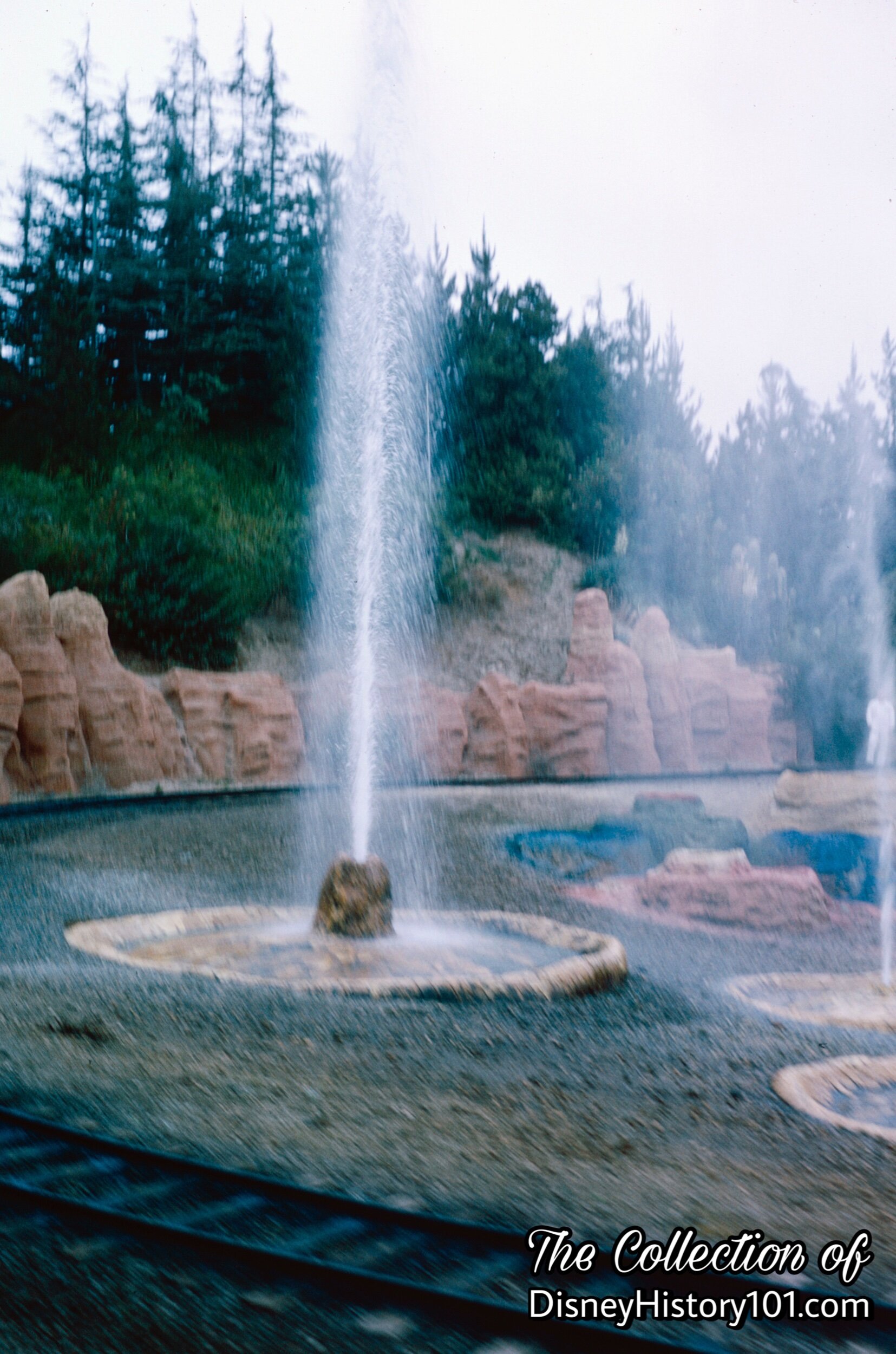
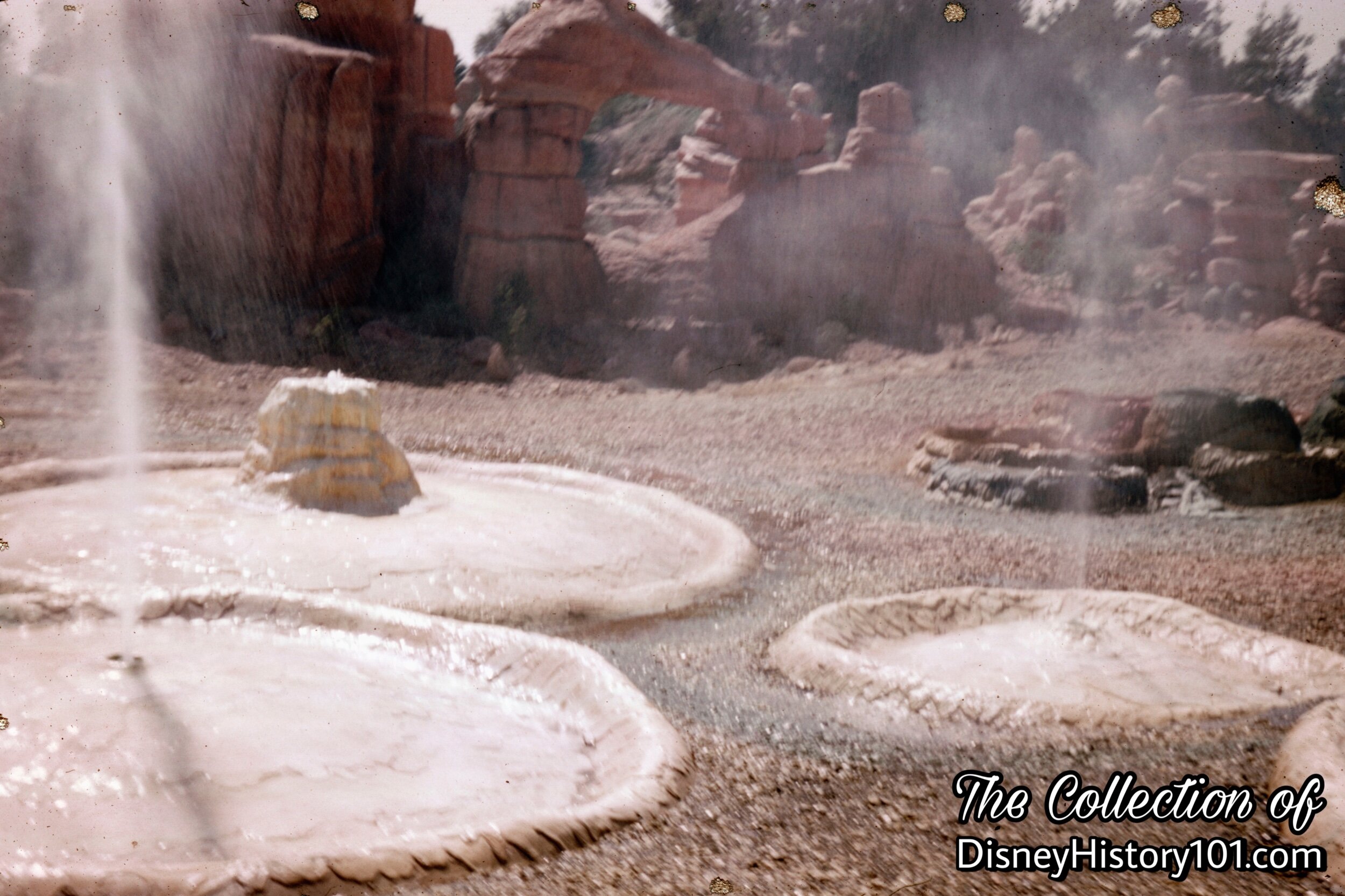
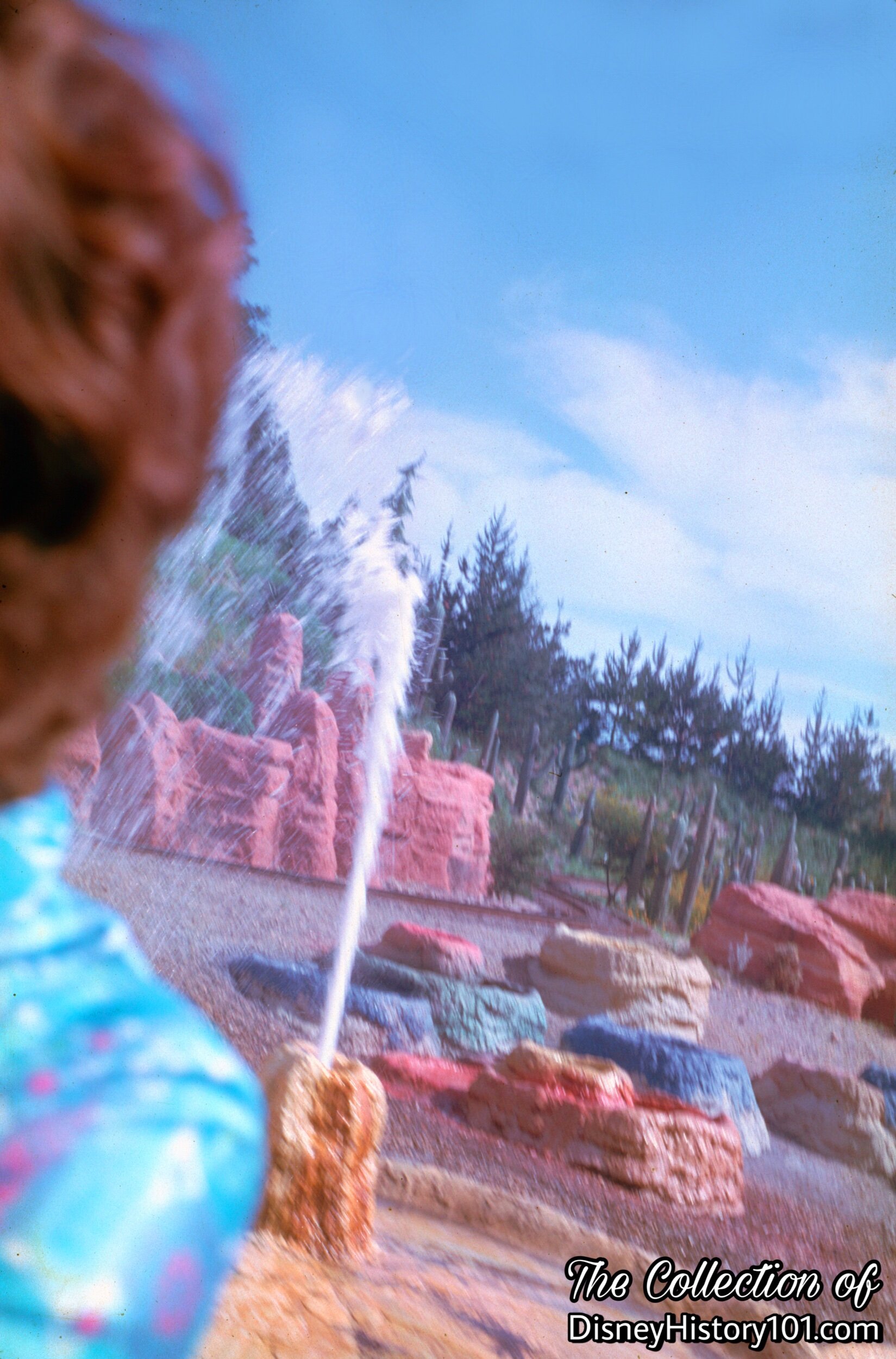
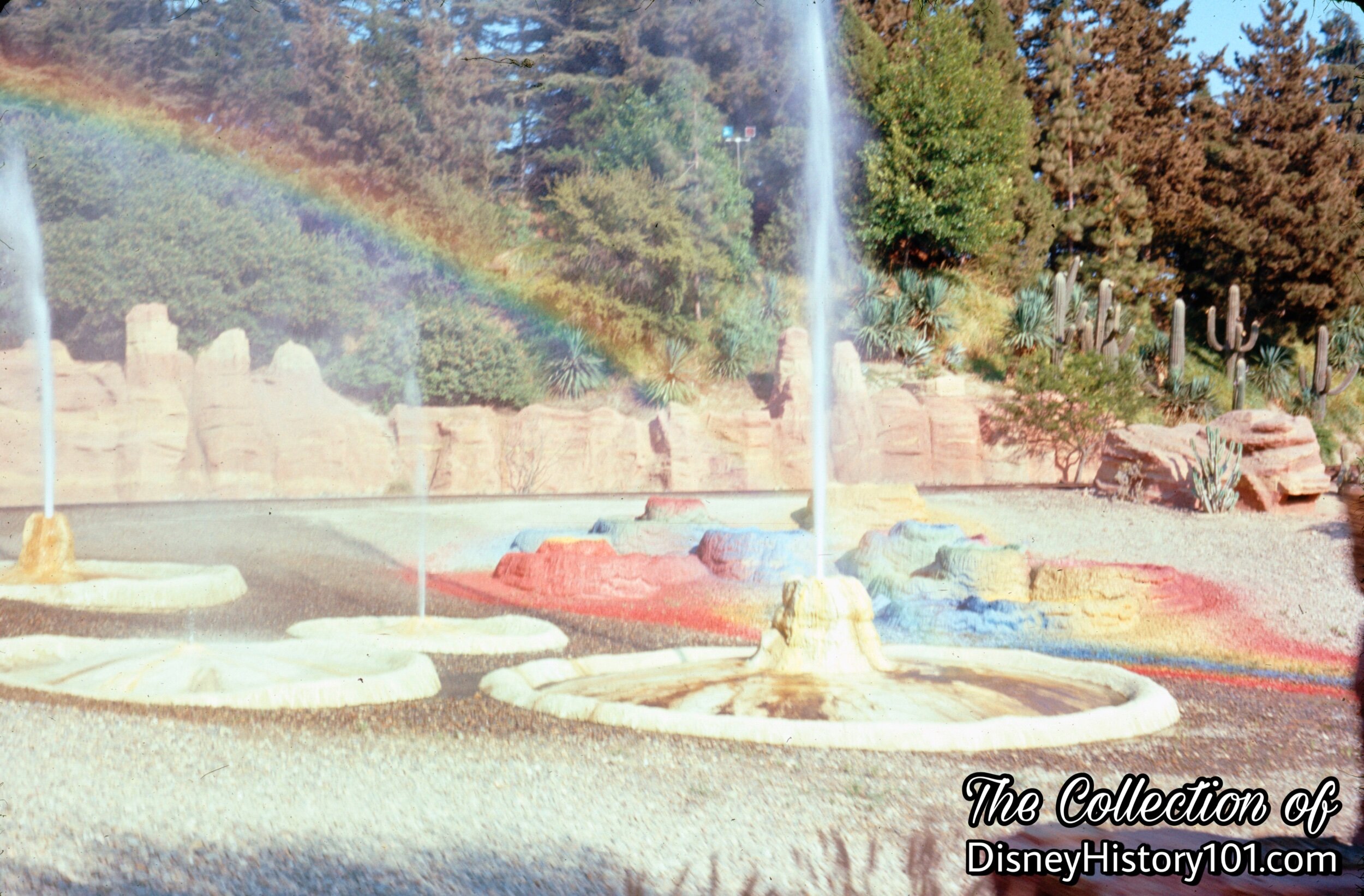
Apparently, rainbows weren’t just seen around the magnificent Rainbow Caverns. Sometimes the hydrogeological conditions of Geyser Country made momentary colorful displays for passengers of passing Mine Trains - rainbows!
Even long after these elements of Disneyland’s own “living desert” have vanished, there’s a rainbow at the end of the Disneyland “Geyser Country” story - a legacy. Decades later, yet another “Geyser Country” would be discovered along the railroad tracks of Euro Disney’s Frontierland! And then there’s Geyser Gulch (part of Grizzly Gulch at Hong Kong Disneyland), accidentally built on top of active geysers. Now it's a great place for water play and to get completely soaked!
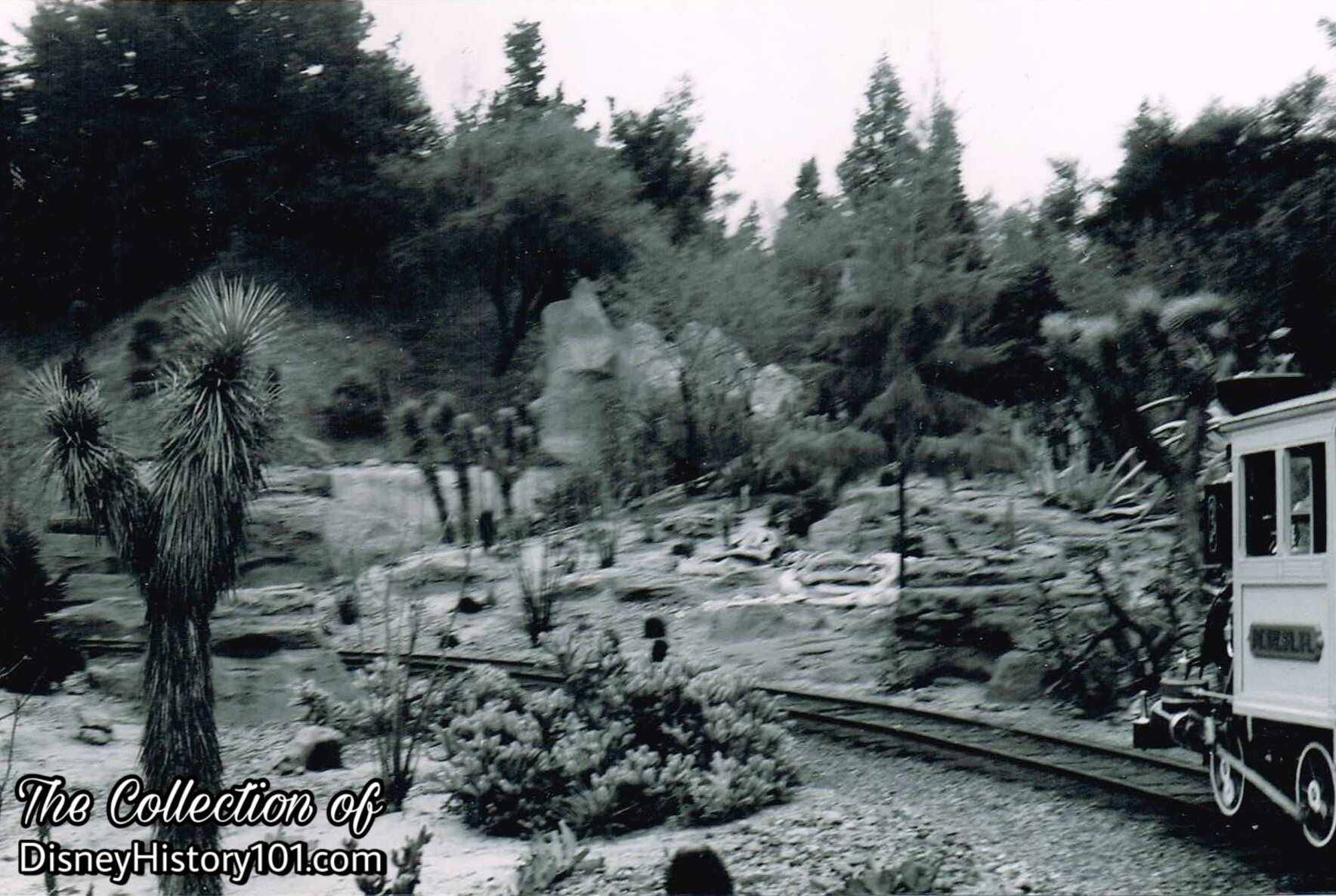
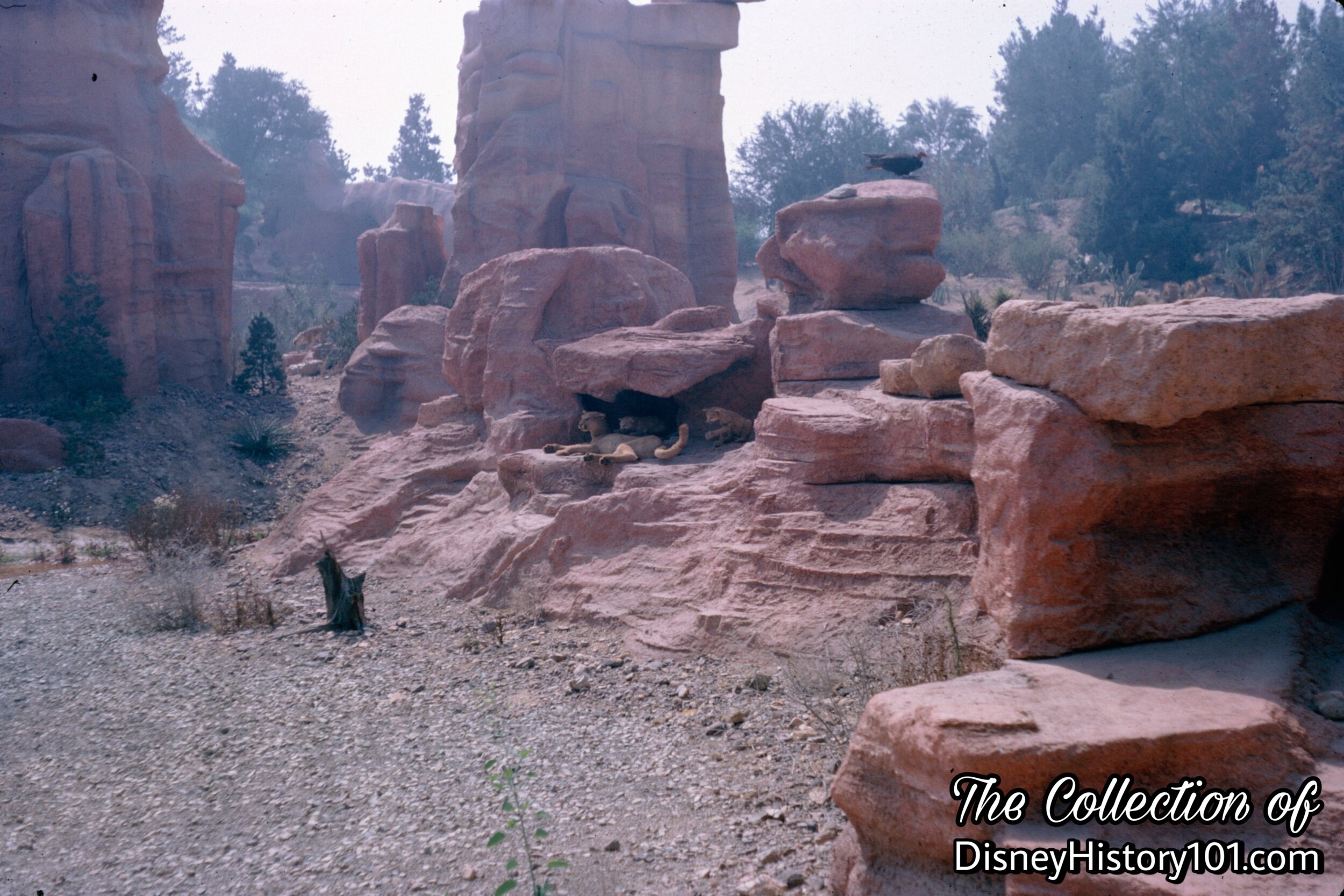
The sounds of the Canyon Wren echo through the rock formations.
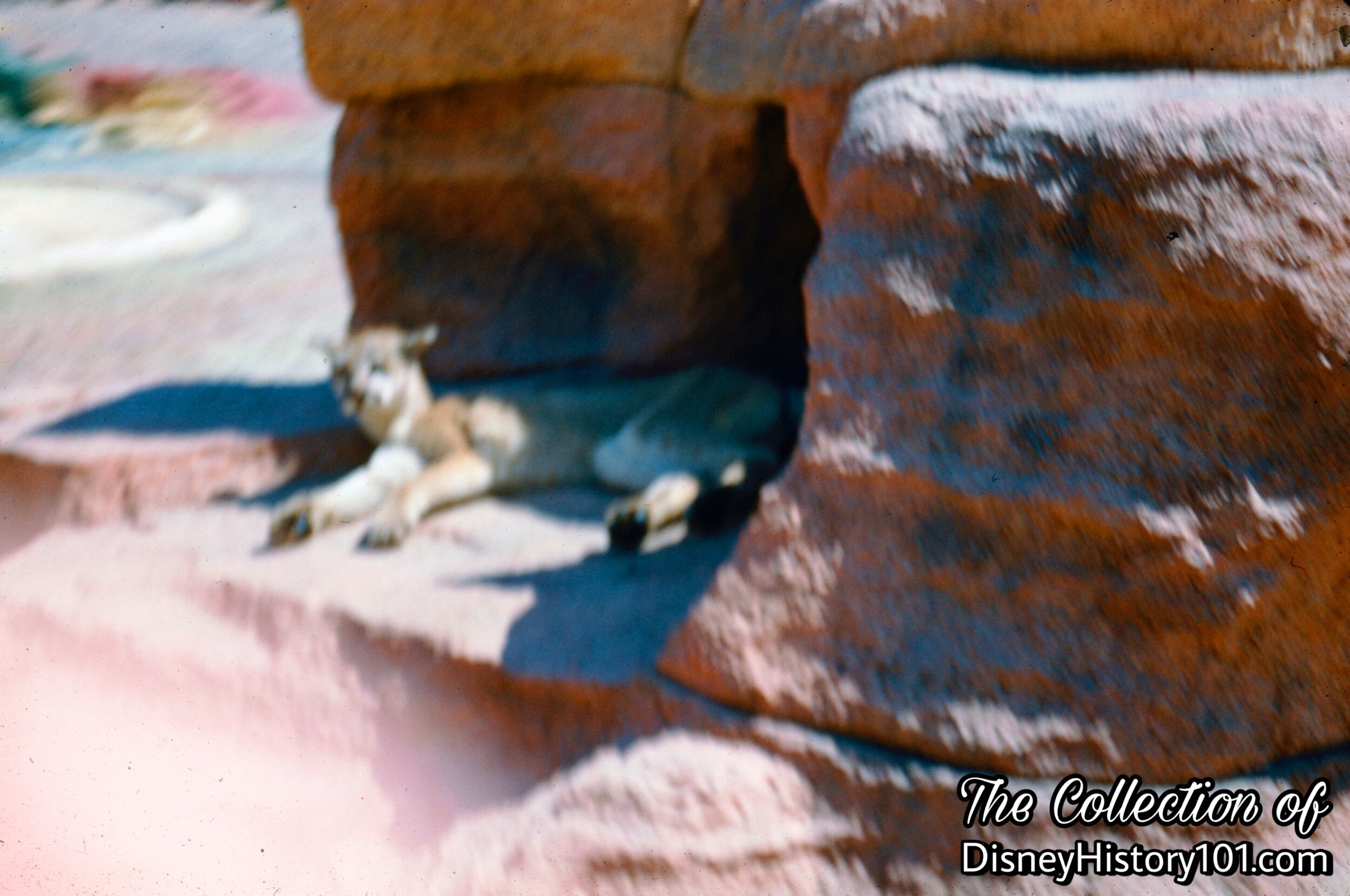
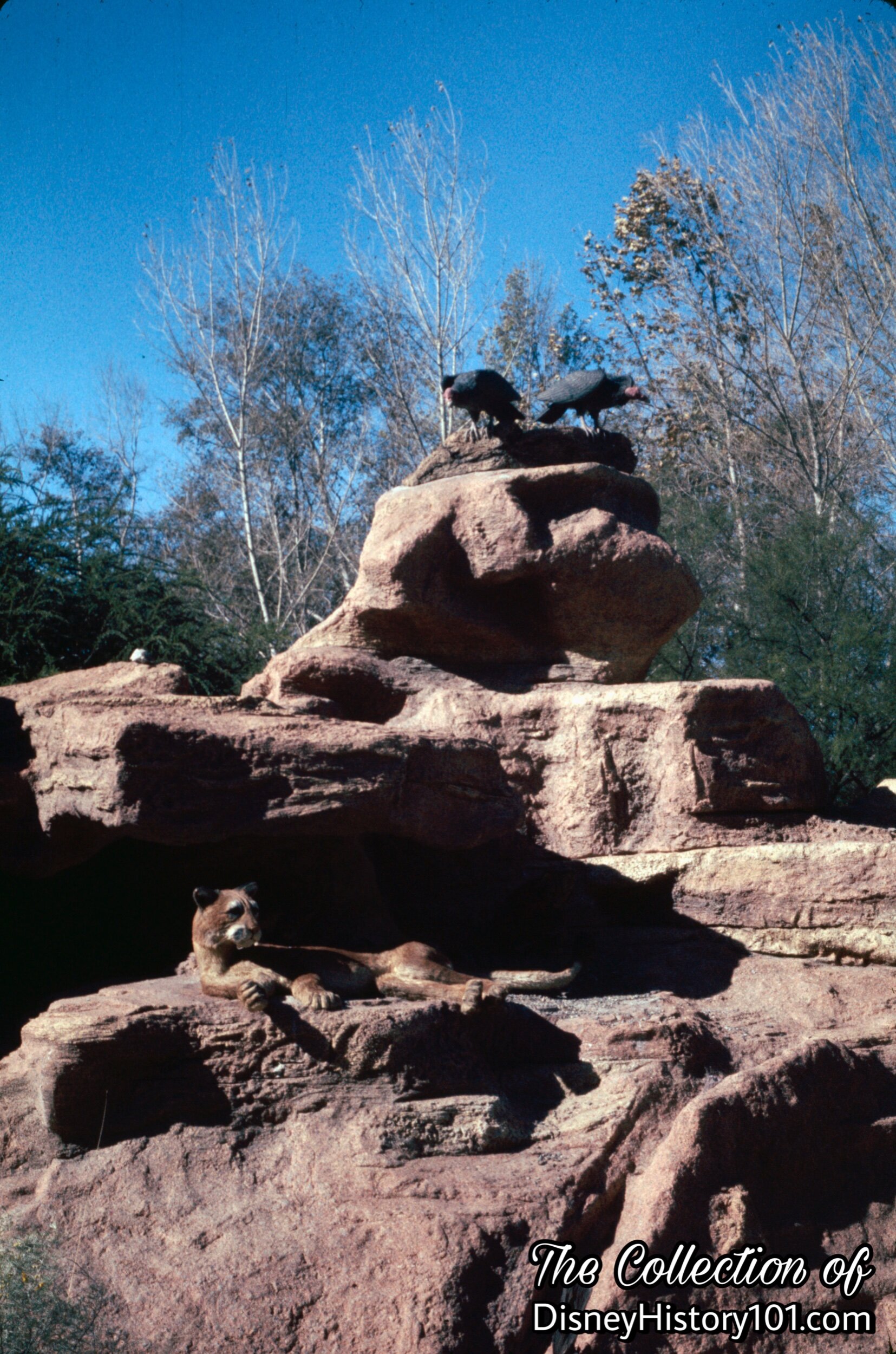
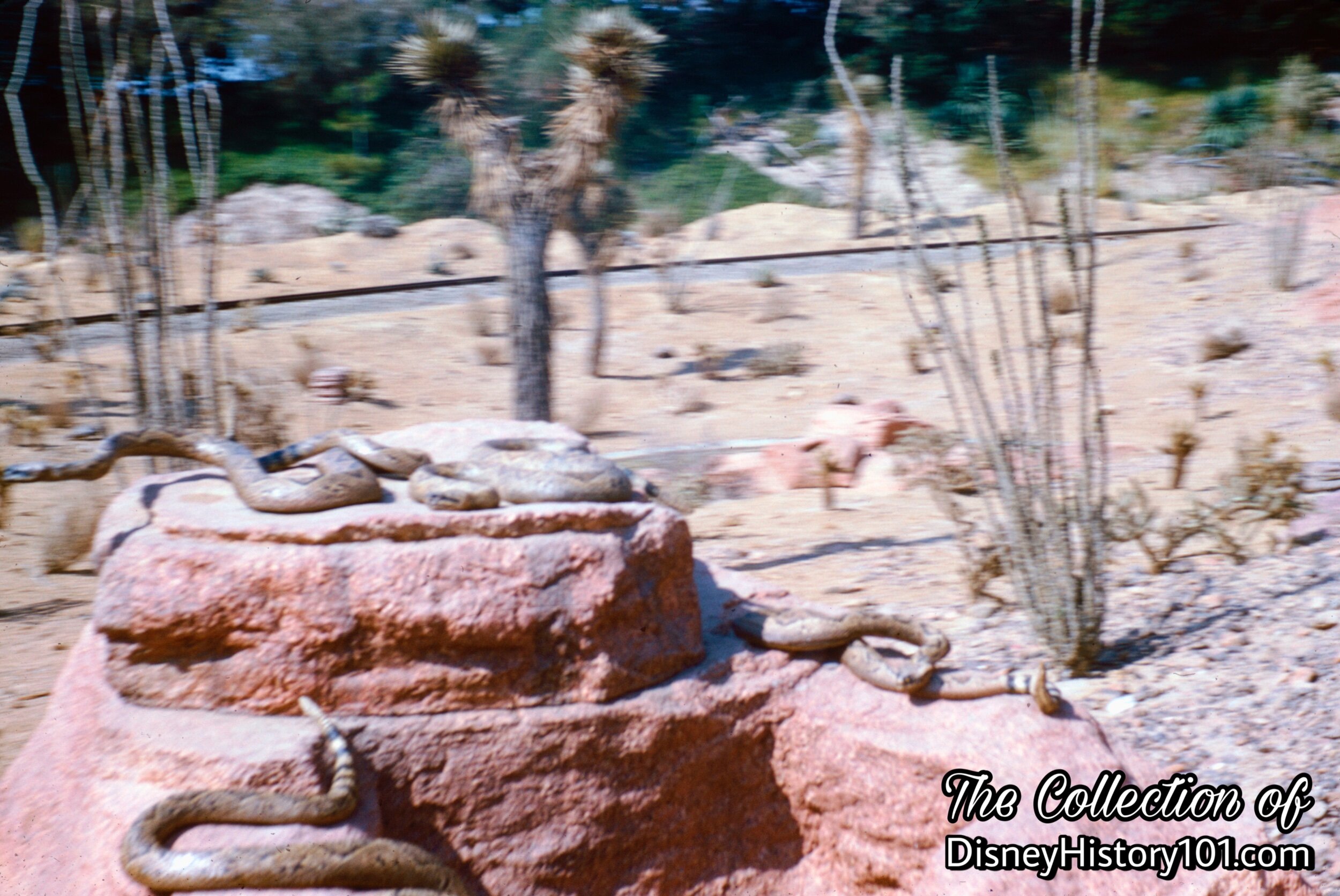

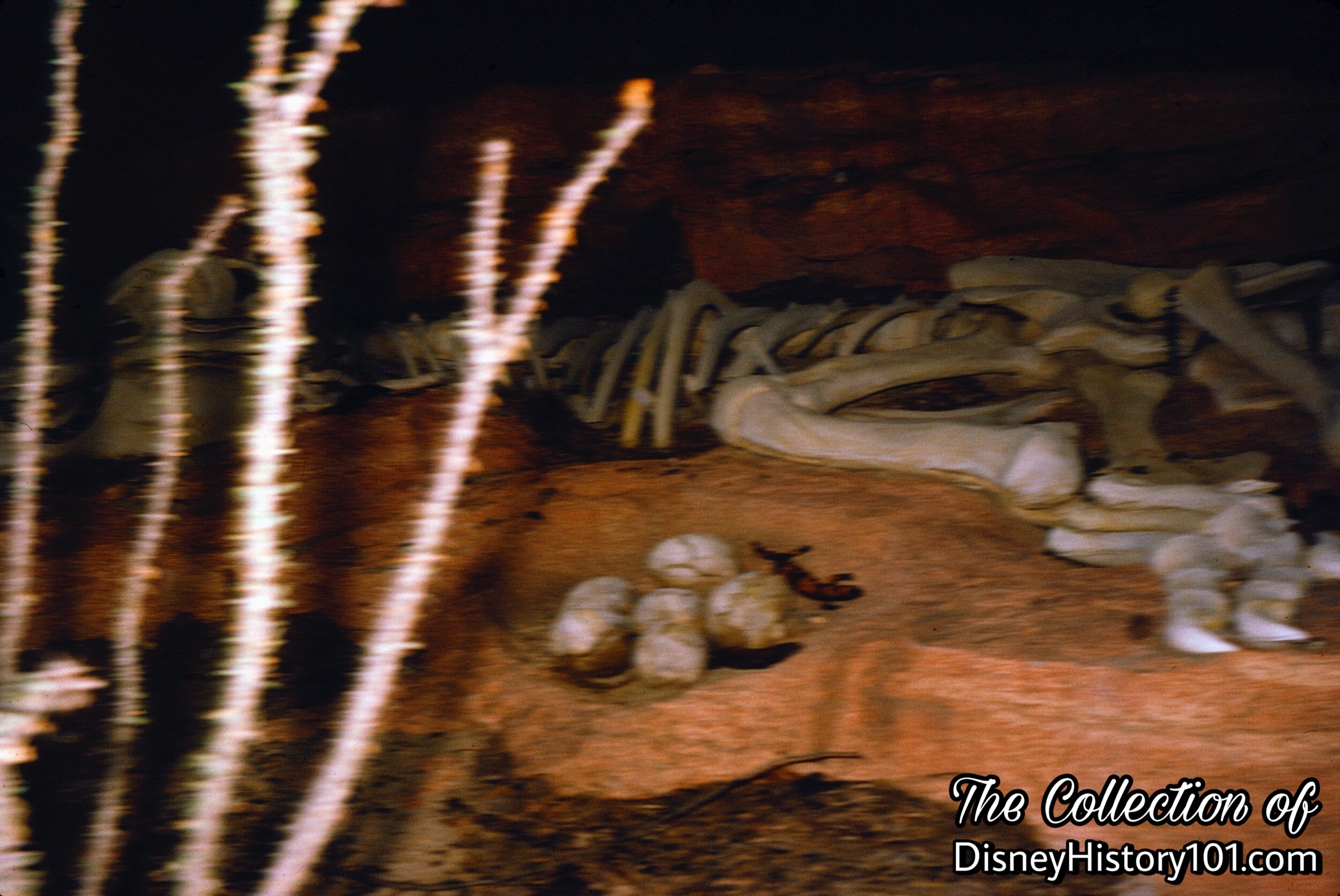
In the early days, “20,000 year old dinosaur tracks near the trail” were observed by Stage Coach passengers (according to “New Frontiers at Disneyland”, published in Mickey Mouse Club Magazine, Vol. 1, No. 3, by Bobby Burgess. Eventually, this fossilized skeleton and nest of eggs were “discovered” by a team of miners. Many years later (and not far away), another dinosaur skeleton would be unearthed near a pool of water at the bottom of Dinosaur Gulch.
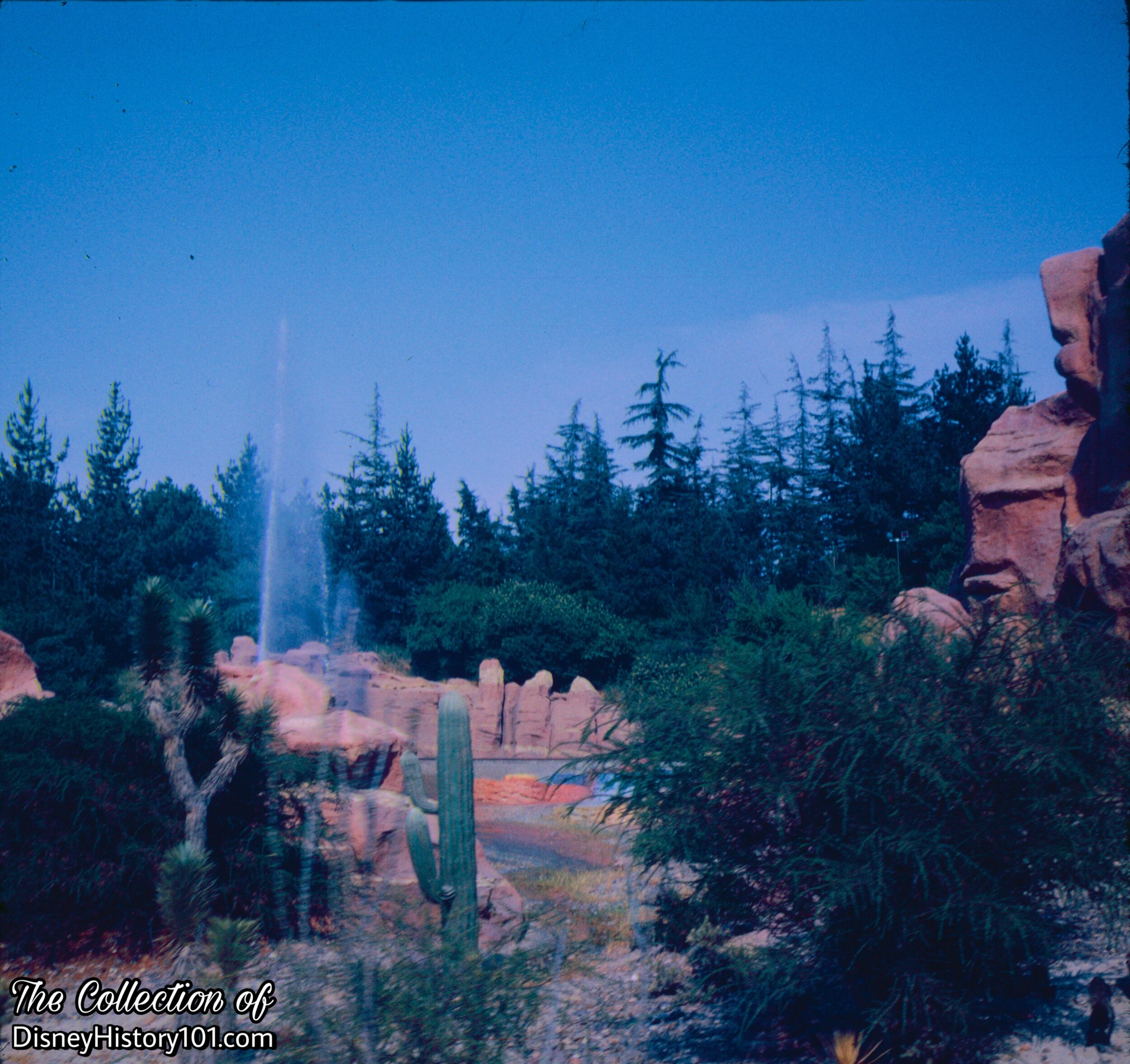
A last look back at those wondrous “Devil’s Paintpots”!
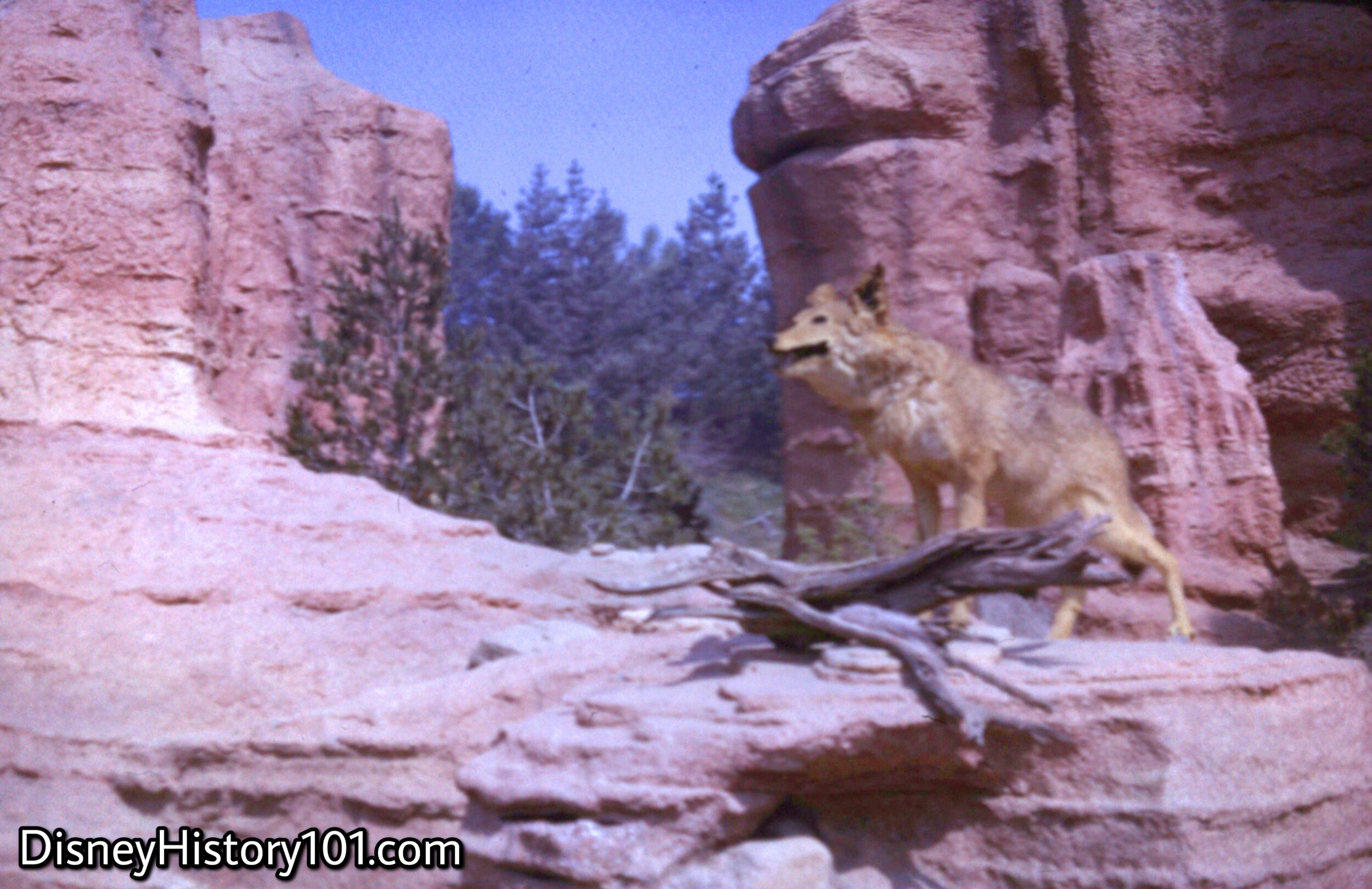
We first encountered one Coyote in Beaver Valley and one Coyote near that den of Mountain Lions. Now, like a scene out of Walt Disney’s True-Life Adventure “The Vanishing Prairie”, six coyotes “howl” and “yip” from the top of a mesa called Coyote Rock. Many years later, the sound of Coyotes would be heard around a place called Coyote Canyon.
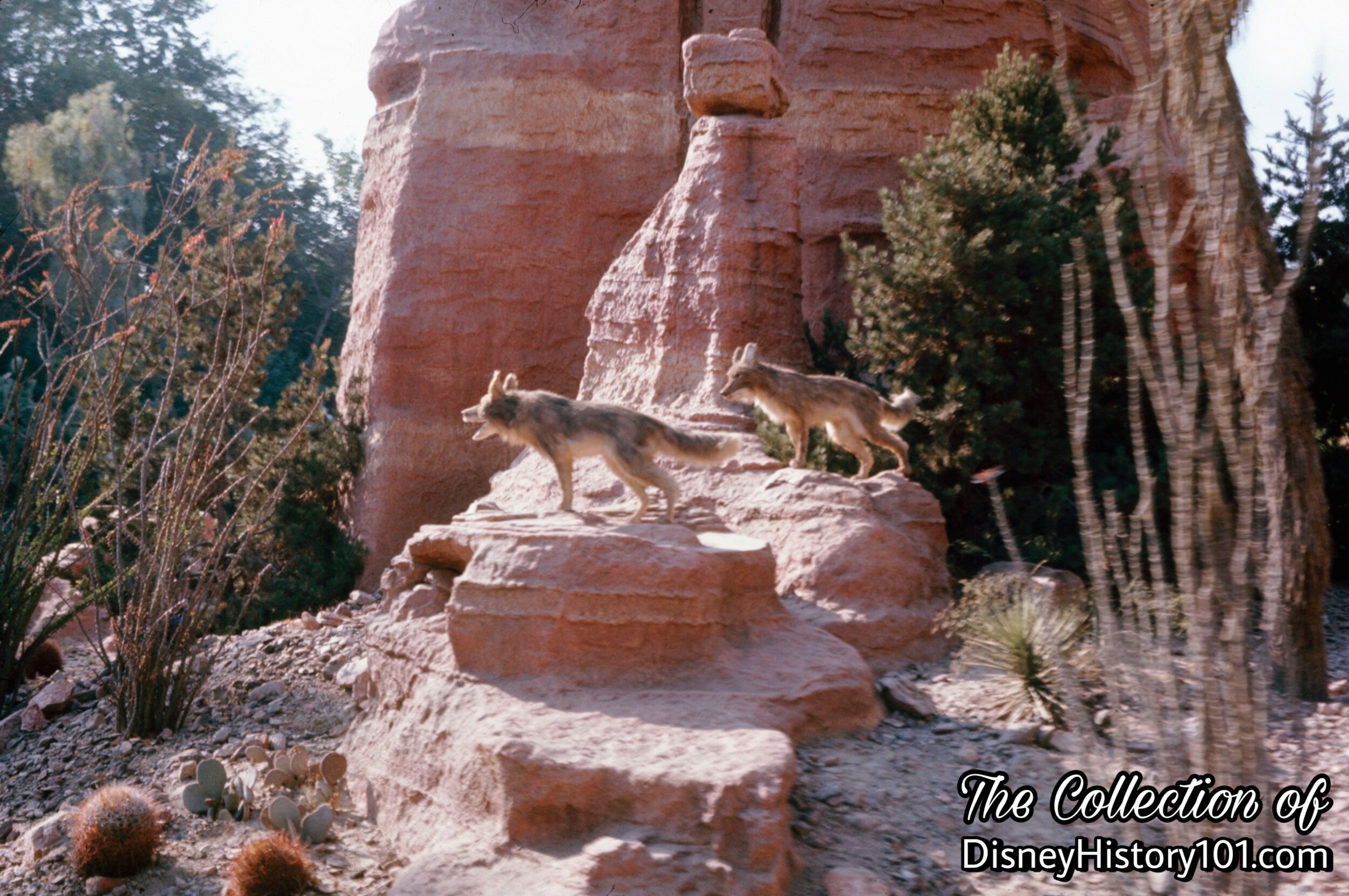
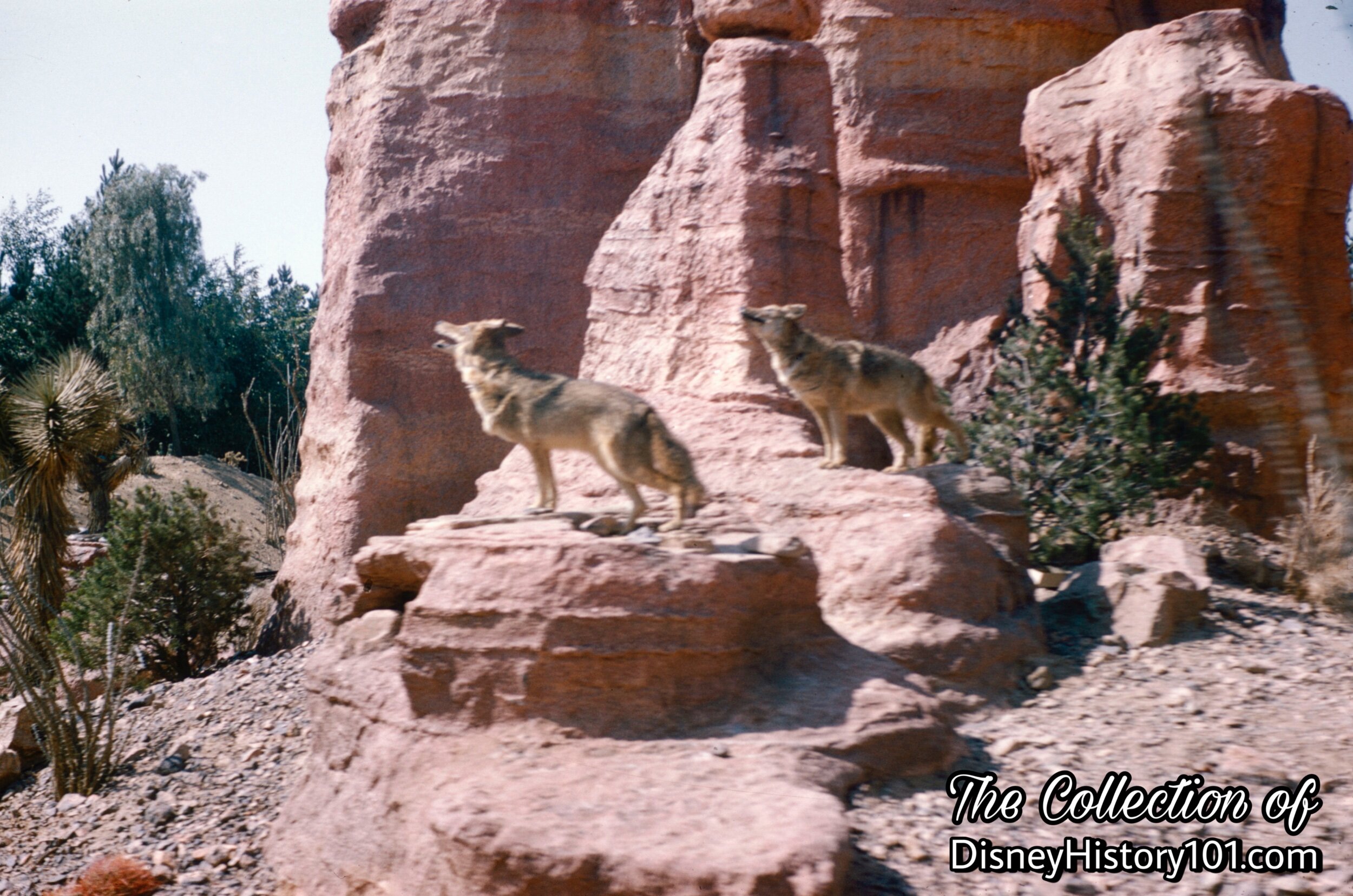
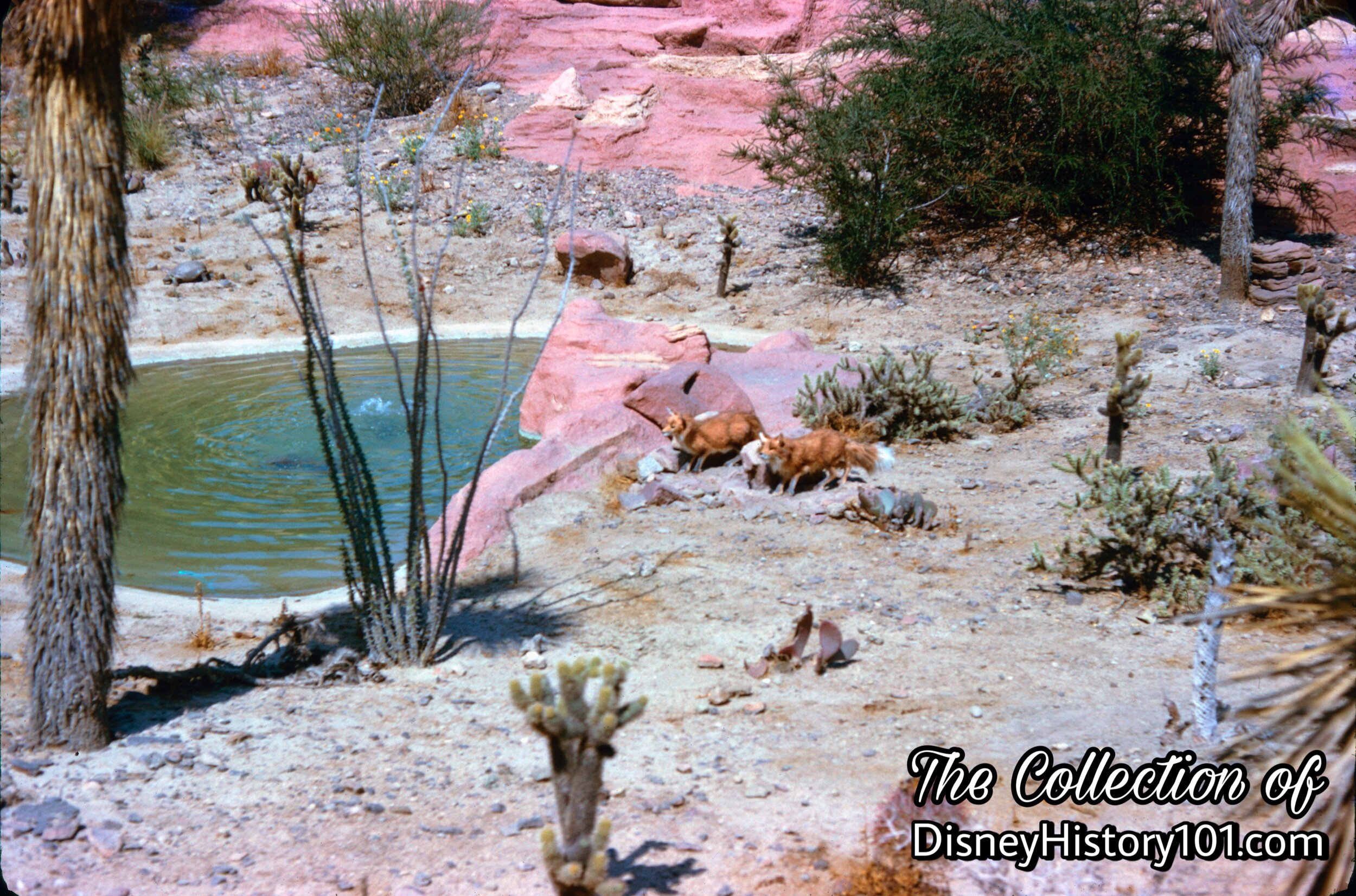
A few kit fox have found the Watering Hole. This seems to be a popular place for Kit Foxes, Jack Rabbits, Tortoise, and Badgers to gather.
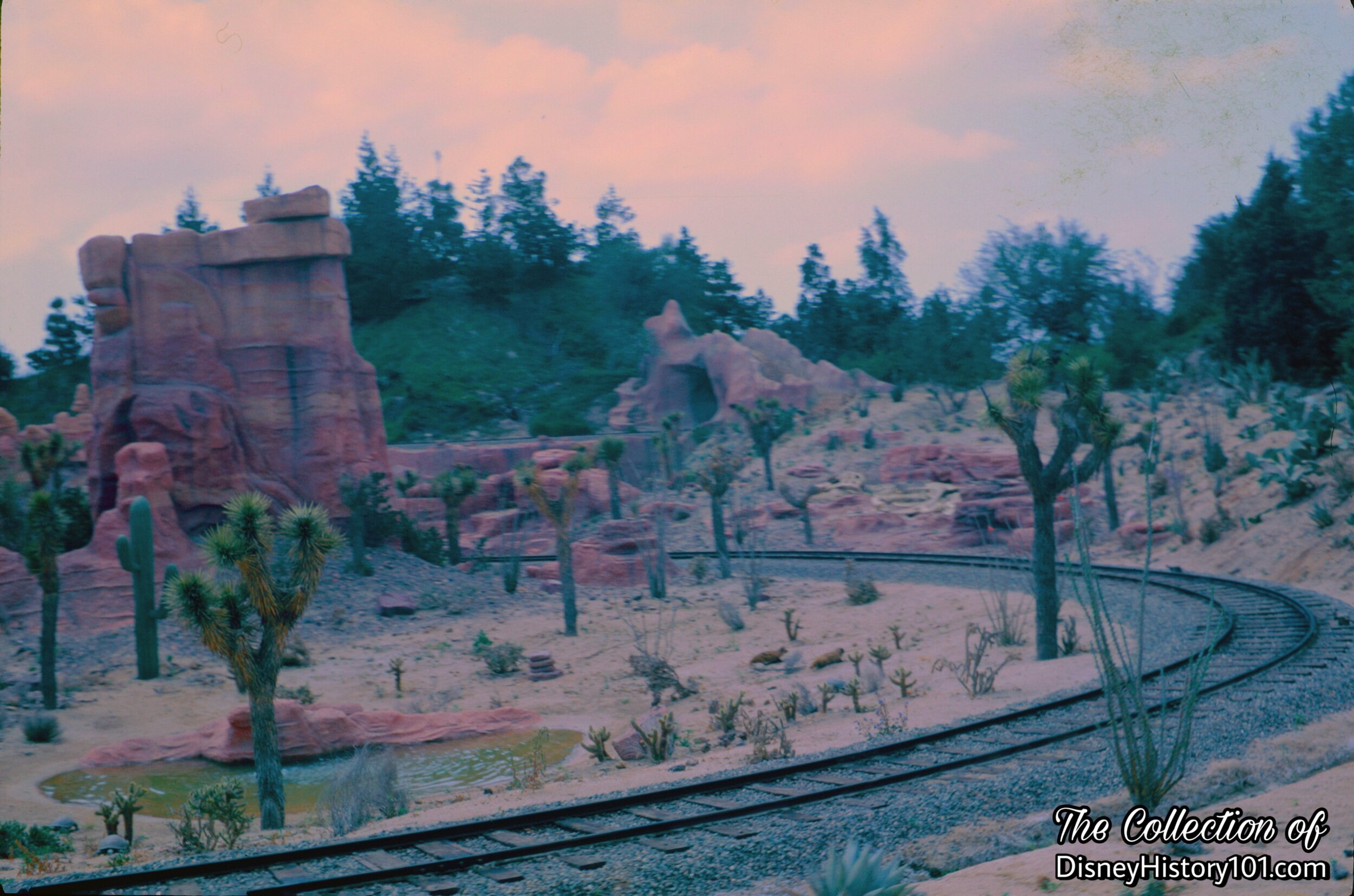
We carefully pass by Rattlesnake Gulch (on the right), we can see a number of beasts and critters (on the left), including tortoises and badgers, who have made their way to the Watering Hole, and are now sunning themselves on the sun-baked terrain of the Living Desert!
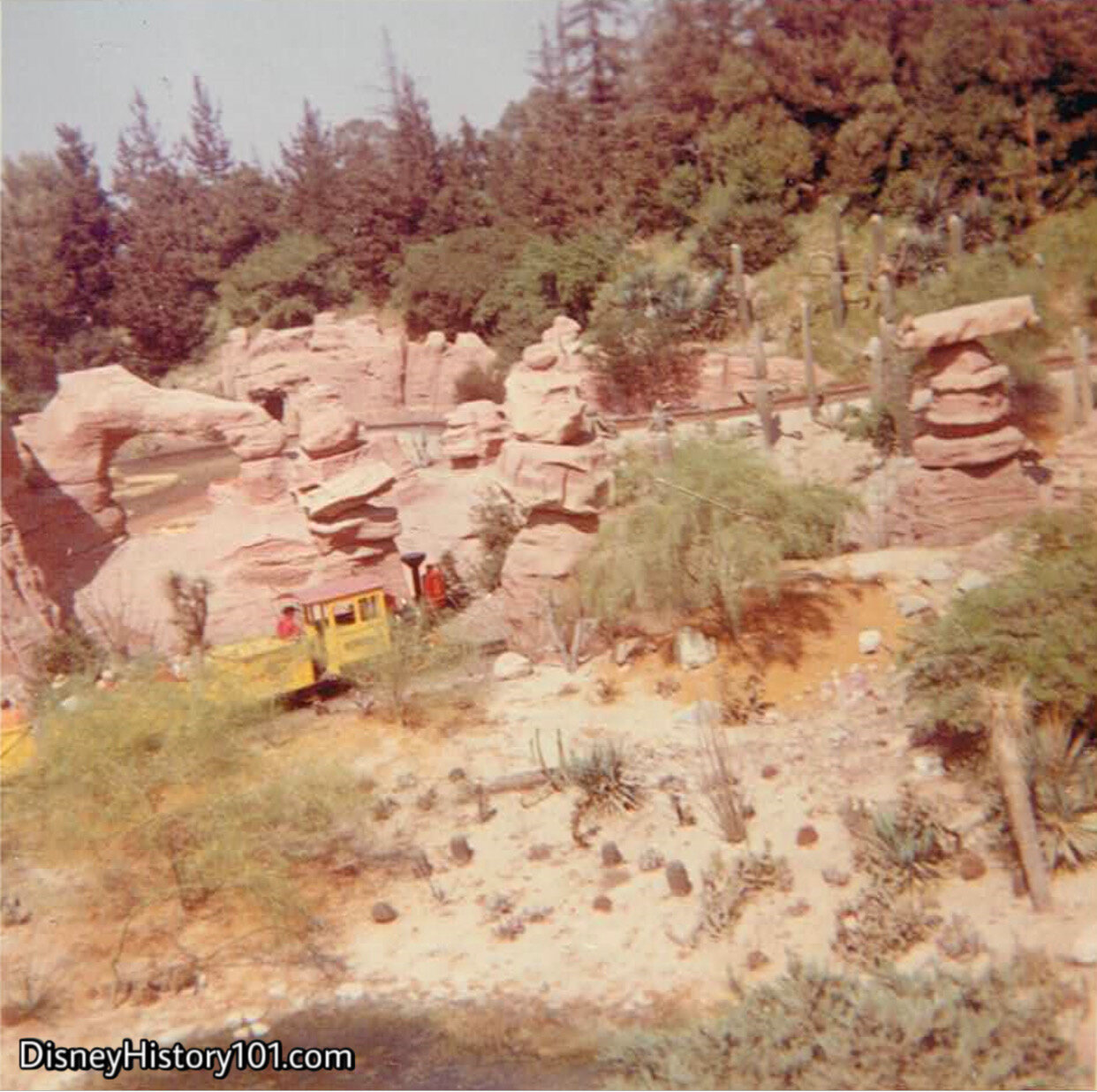
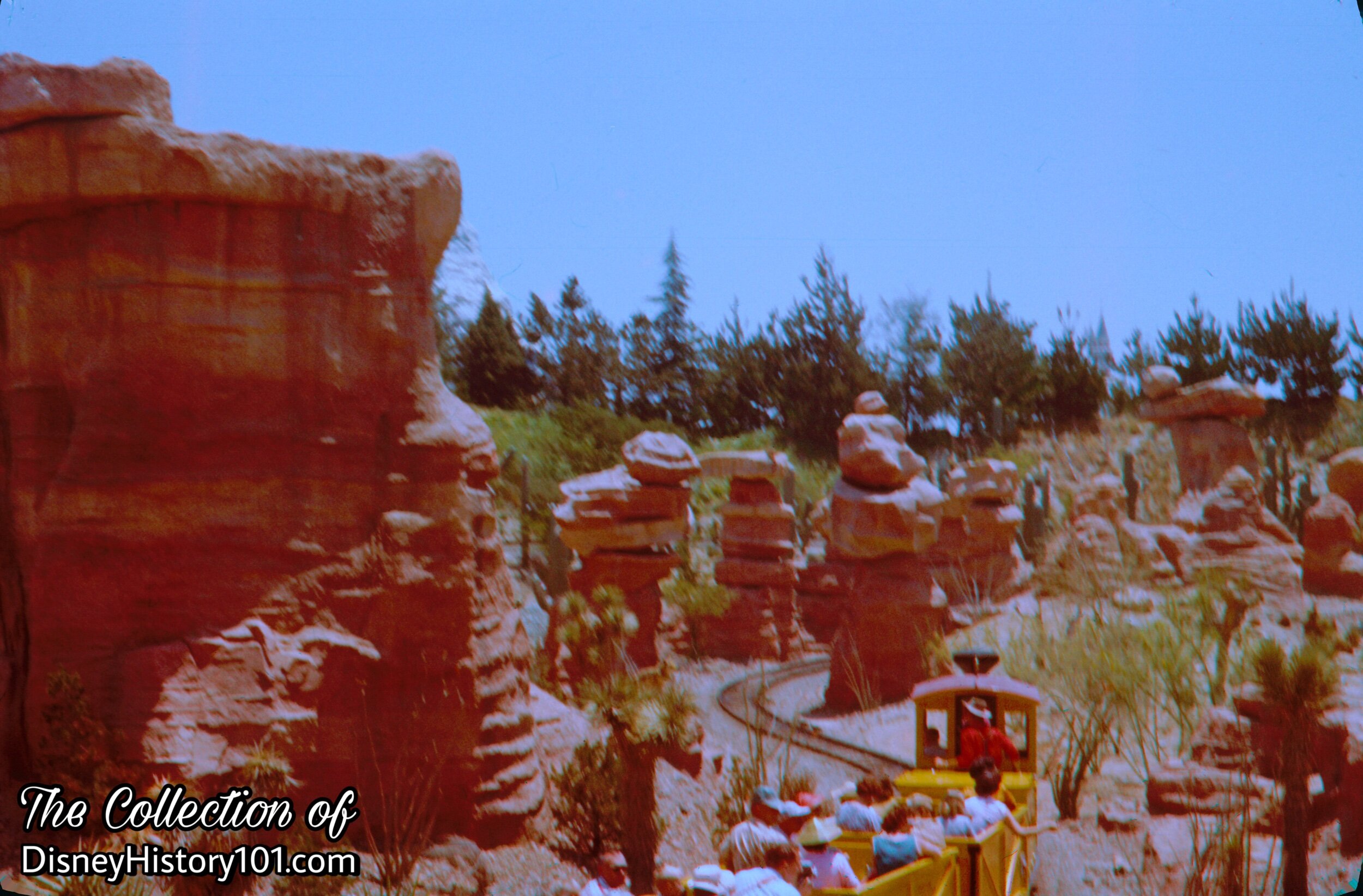
“Look out, they’re startin’ to tumble!”
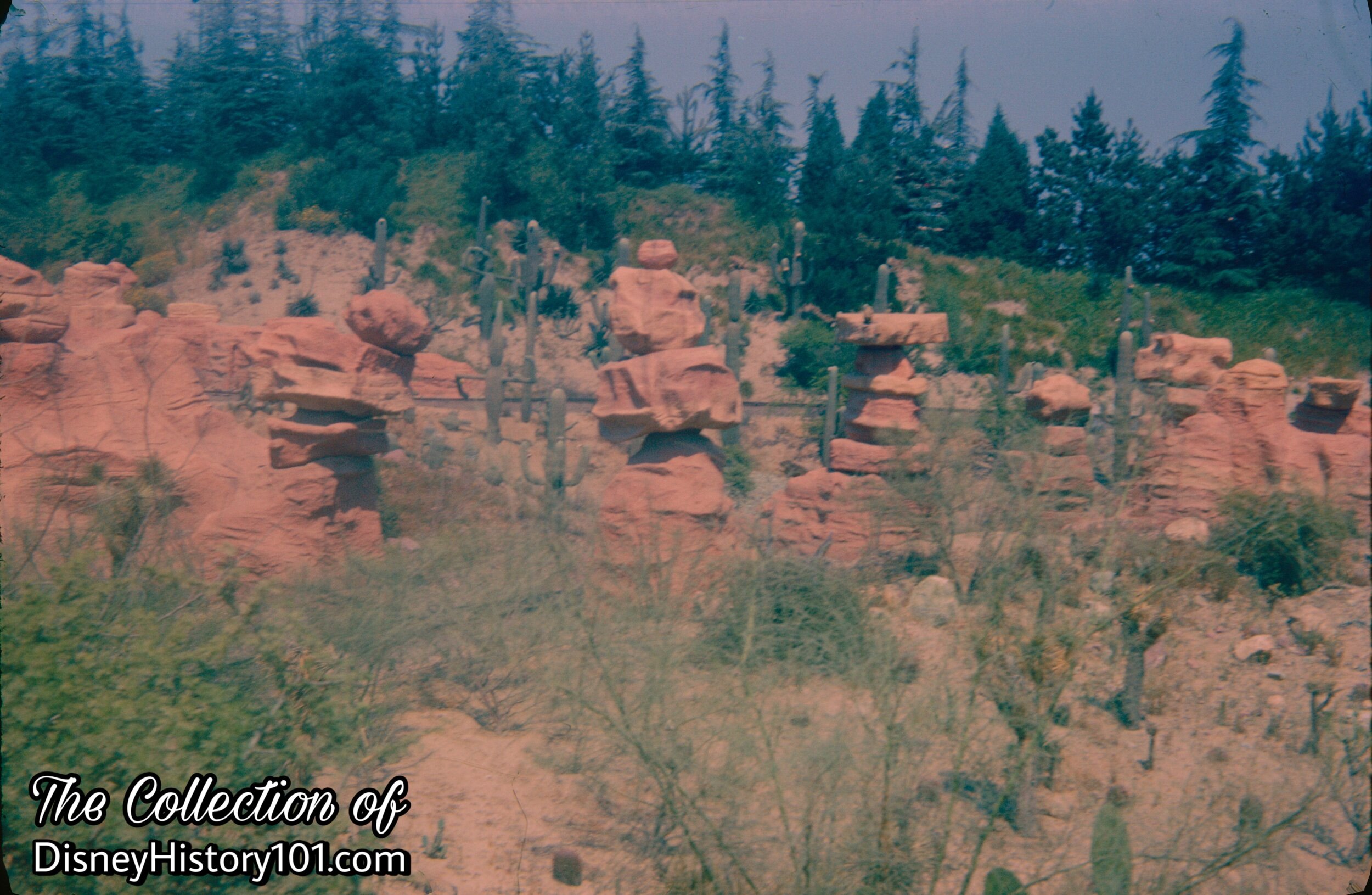
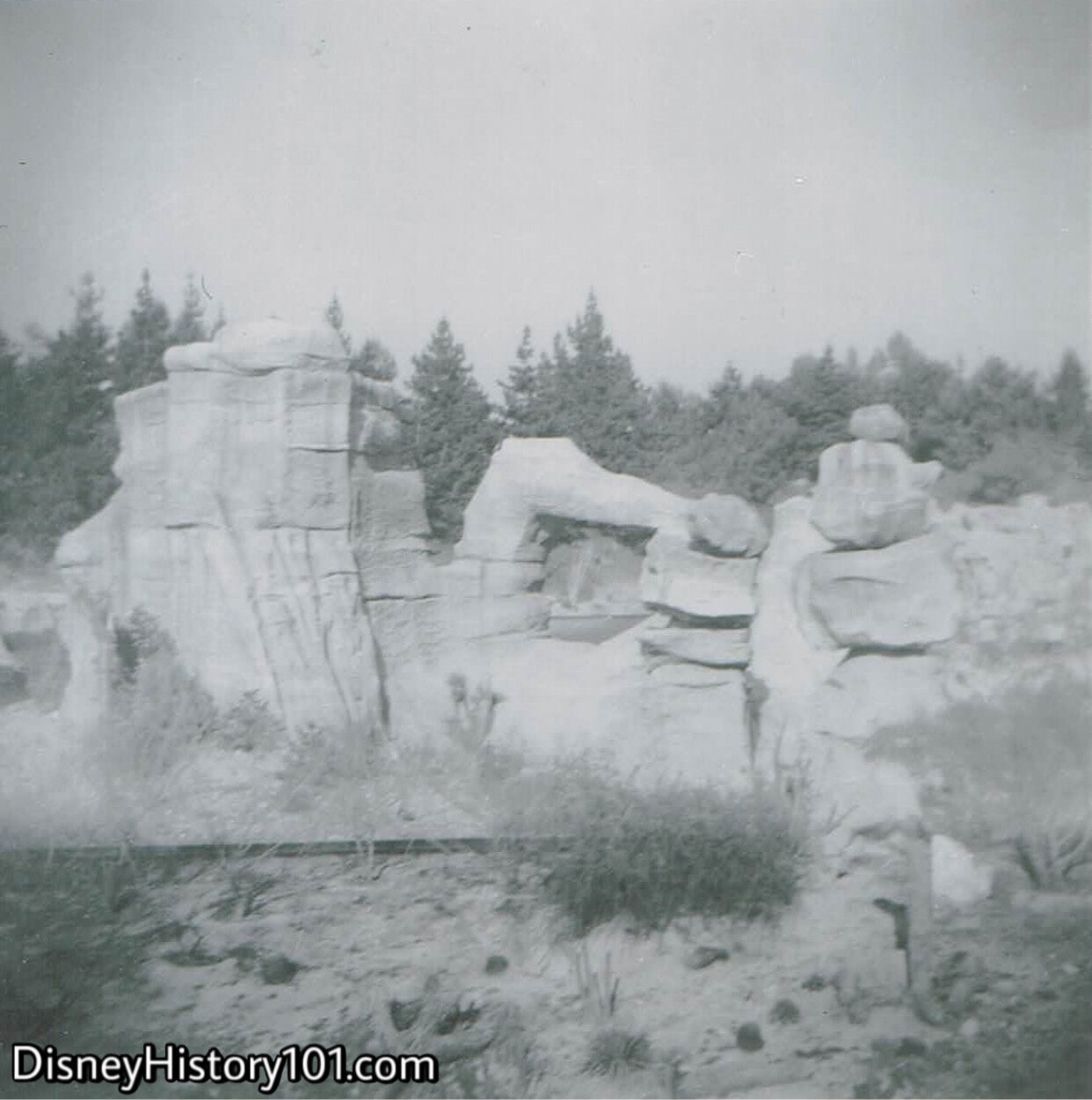
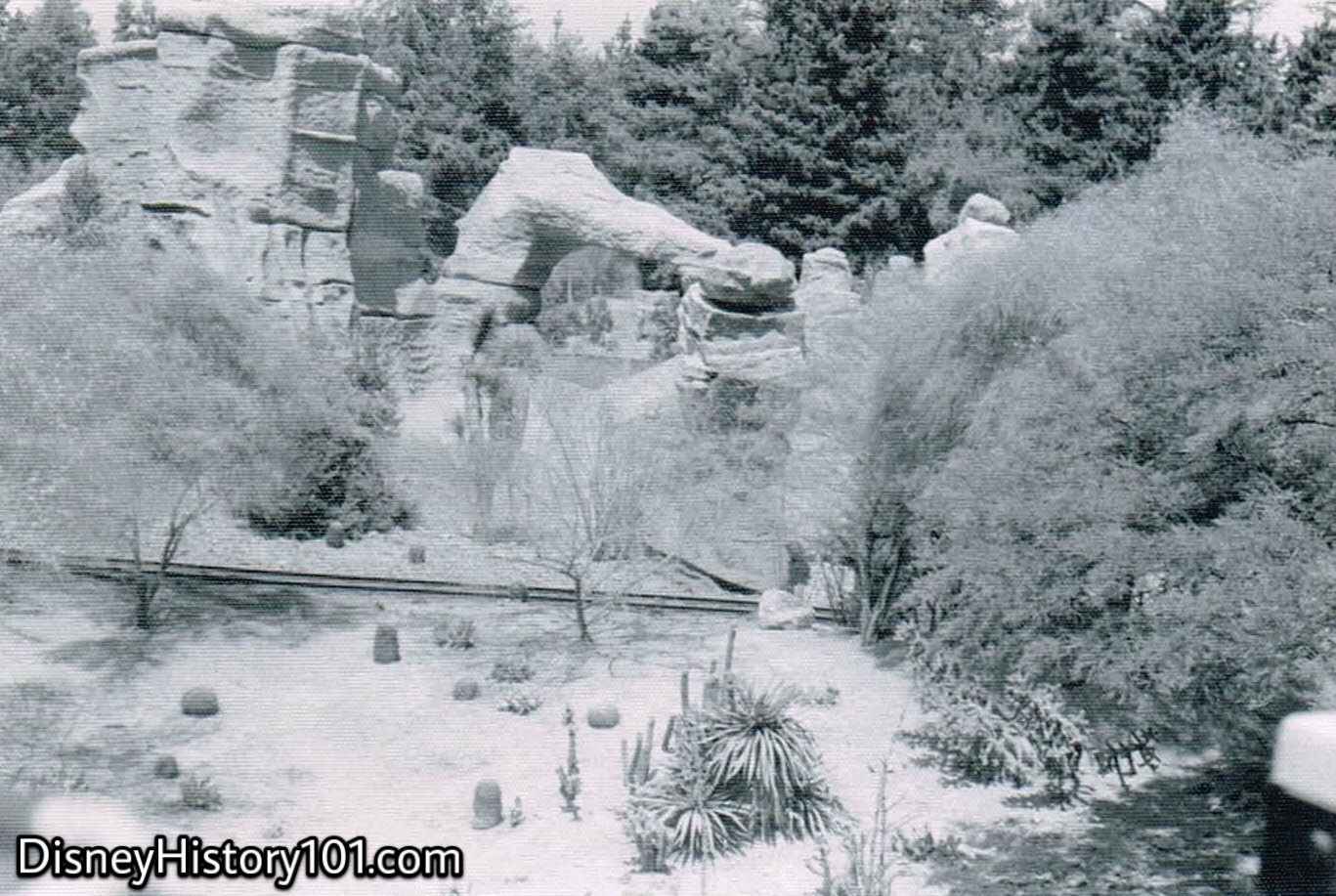
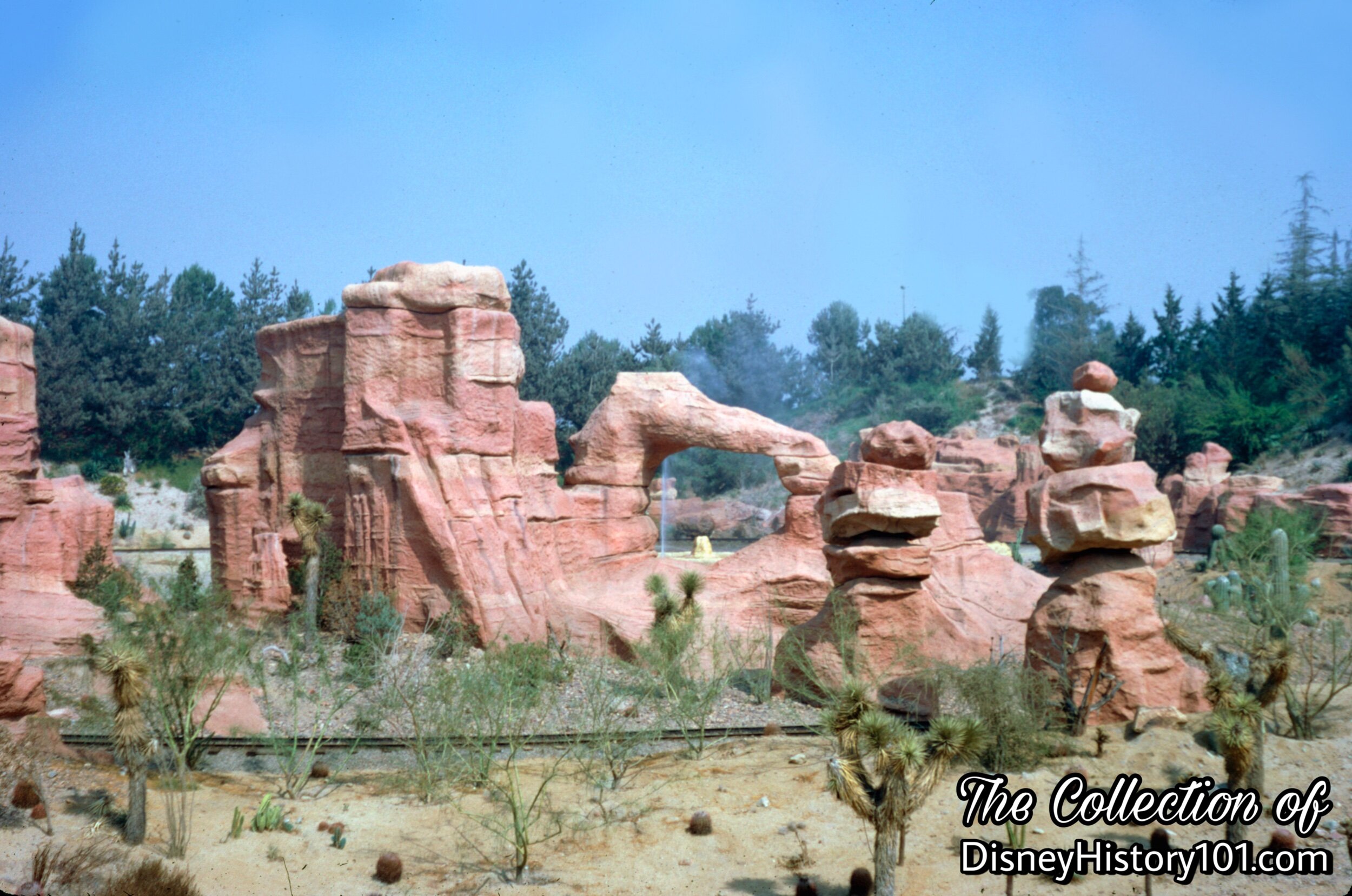
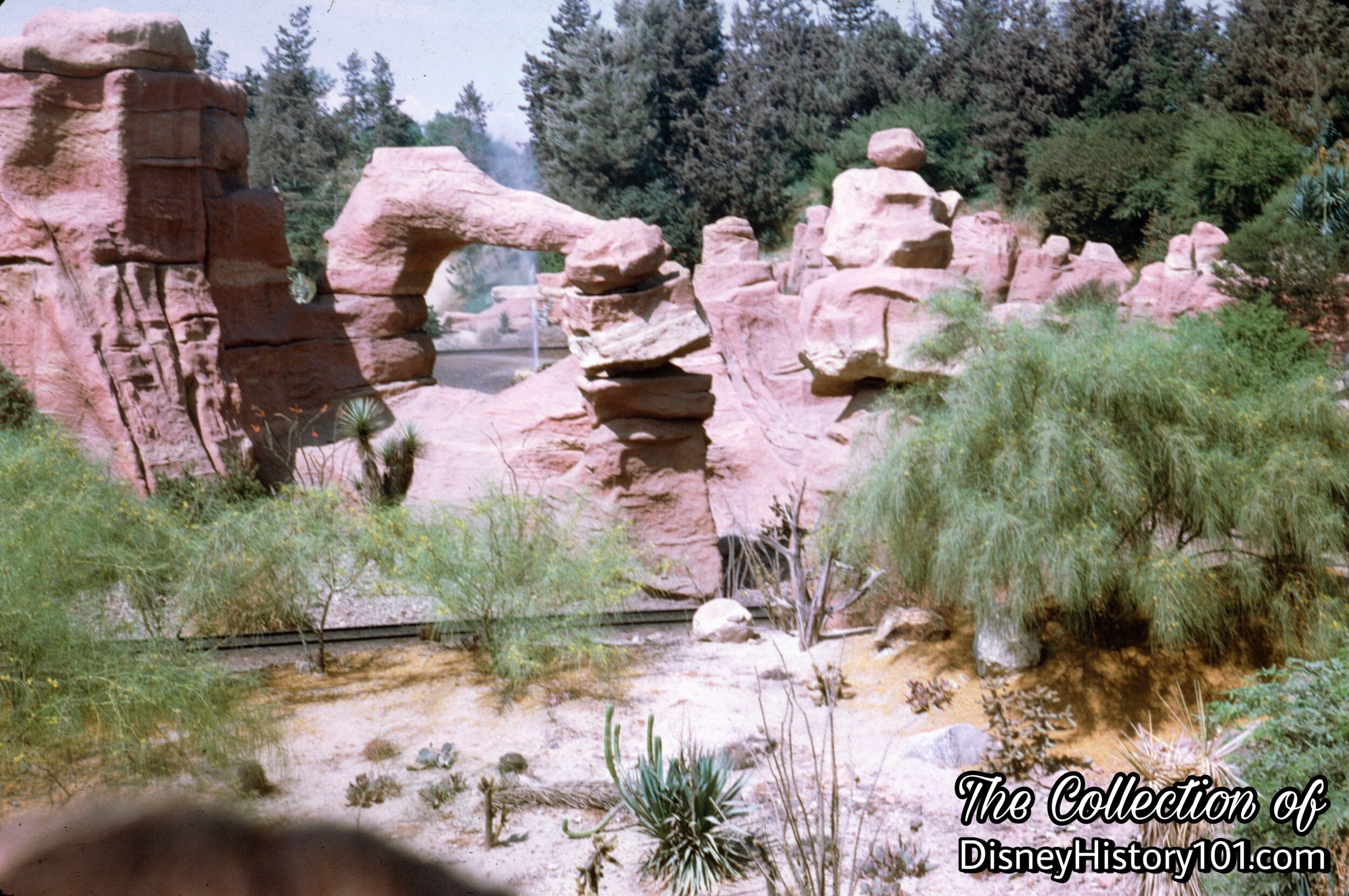
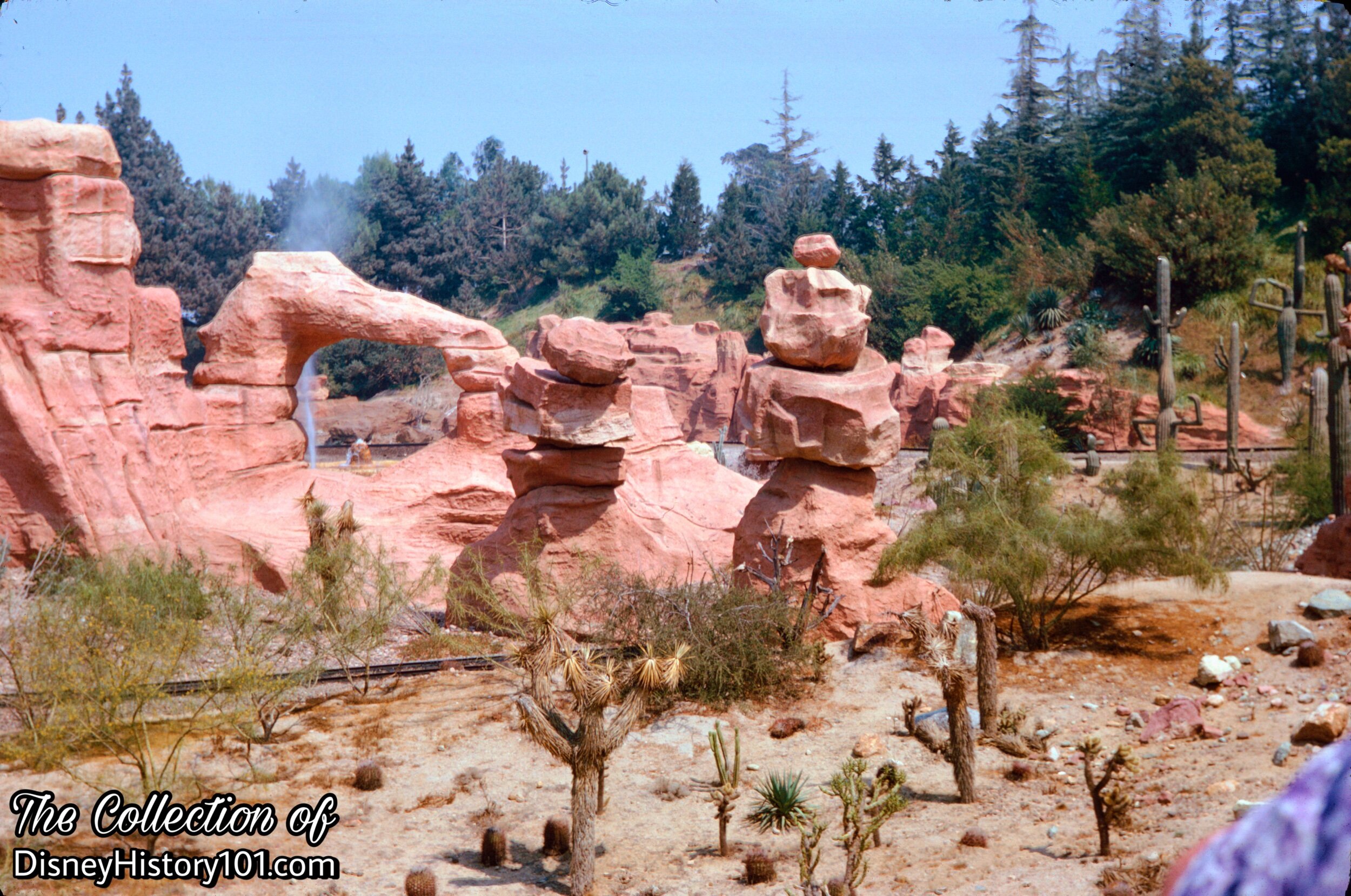
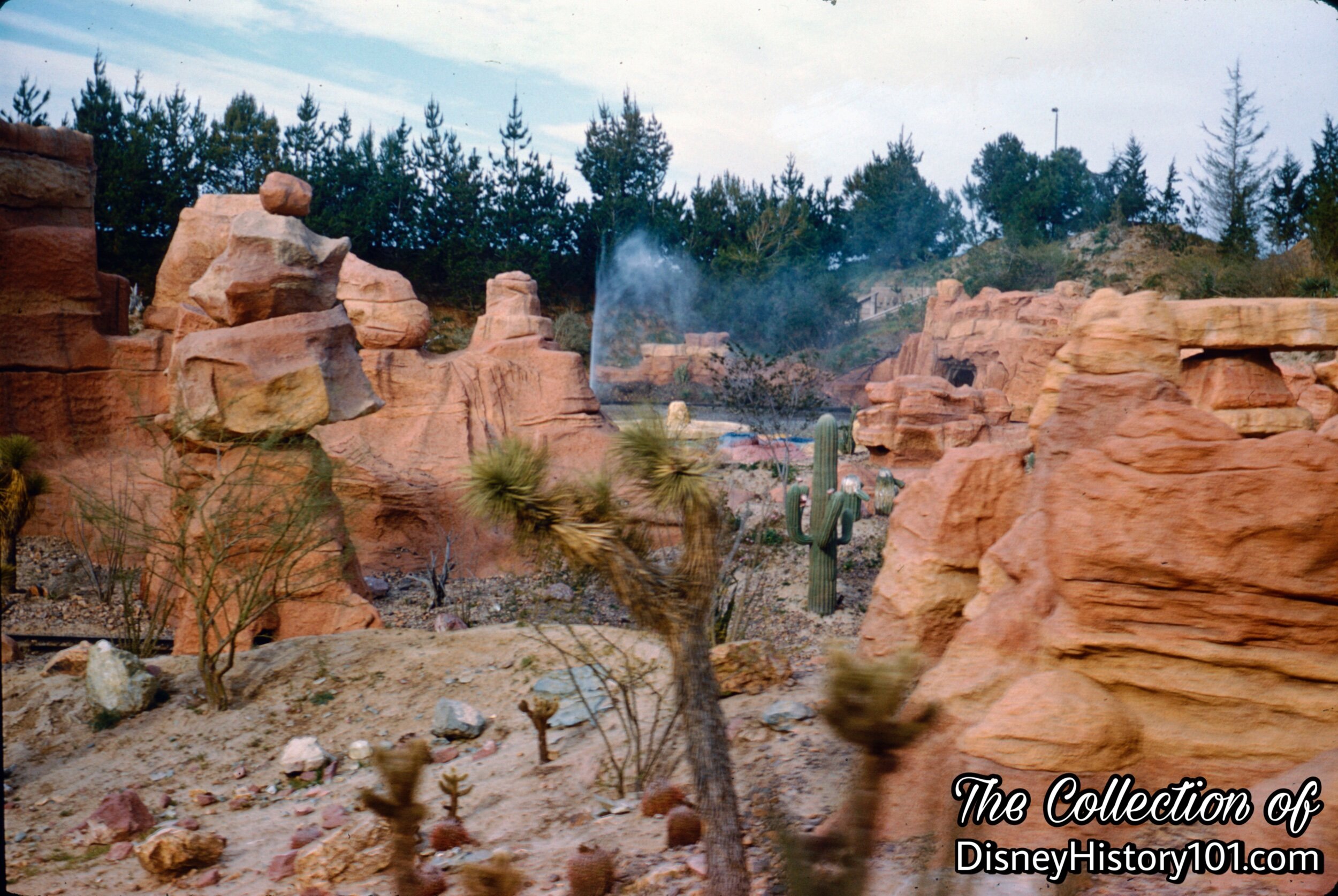
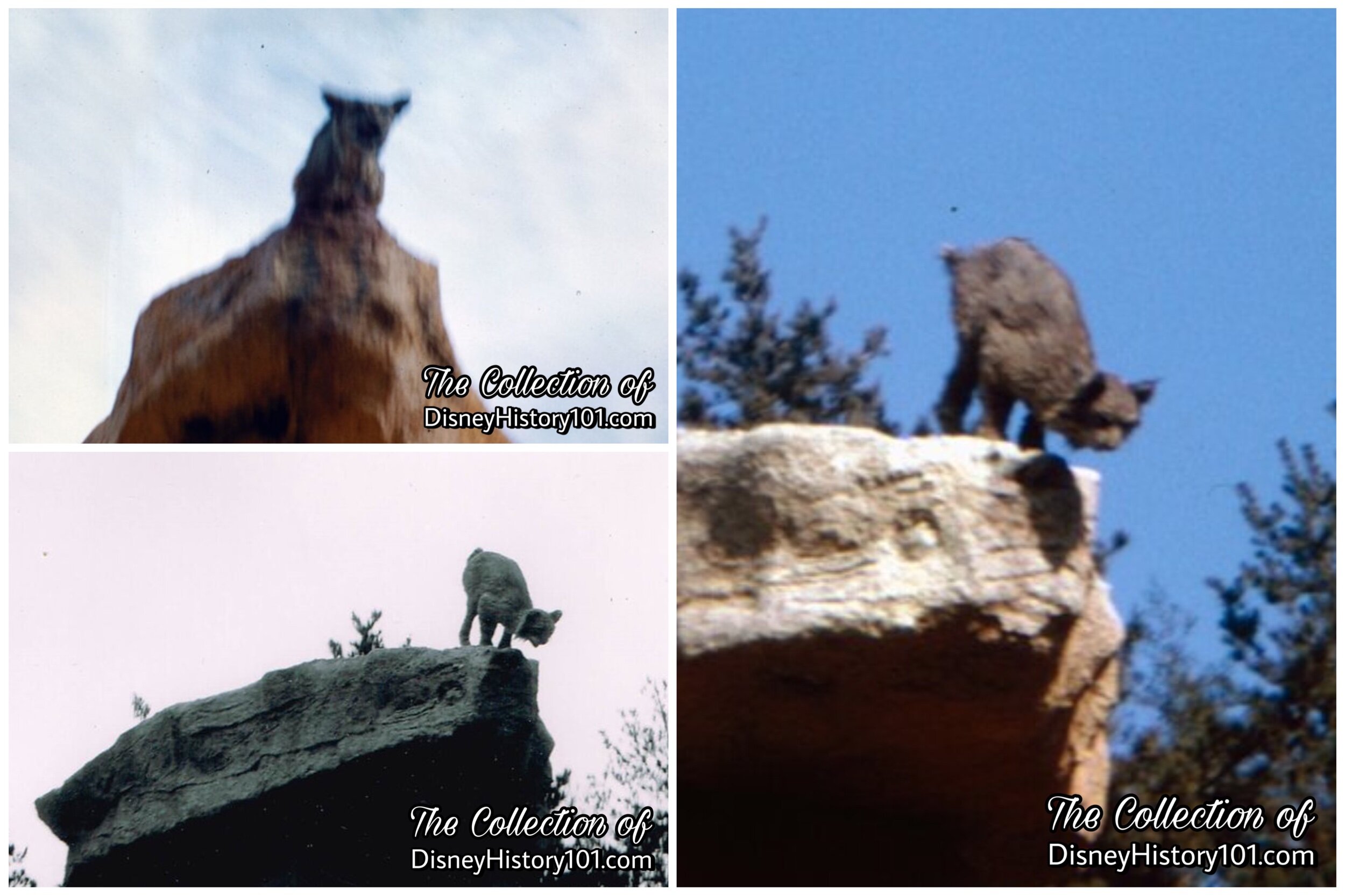
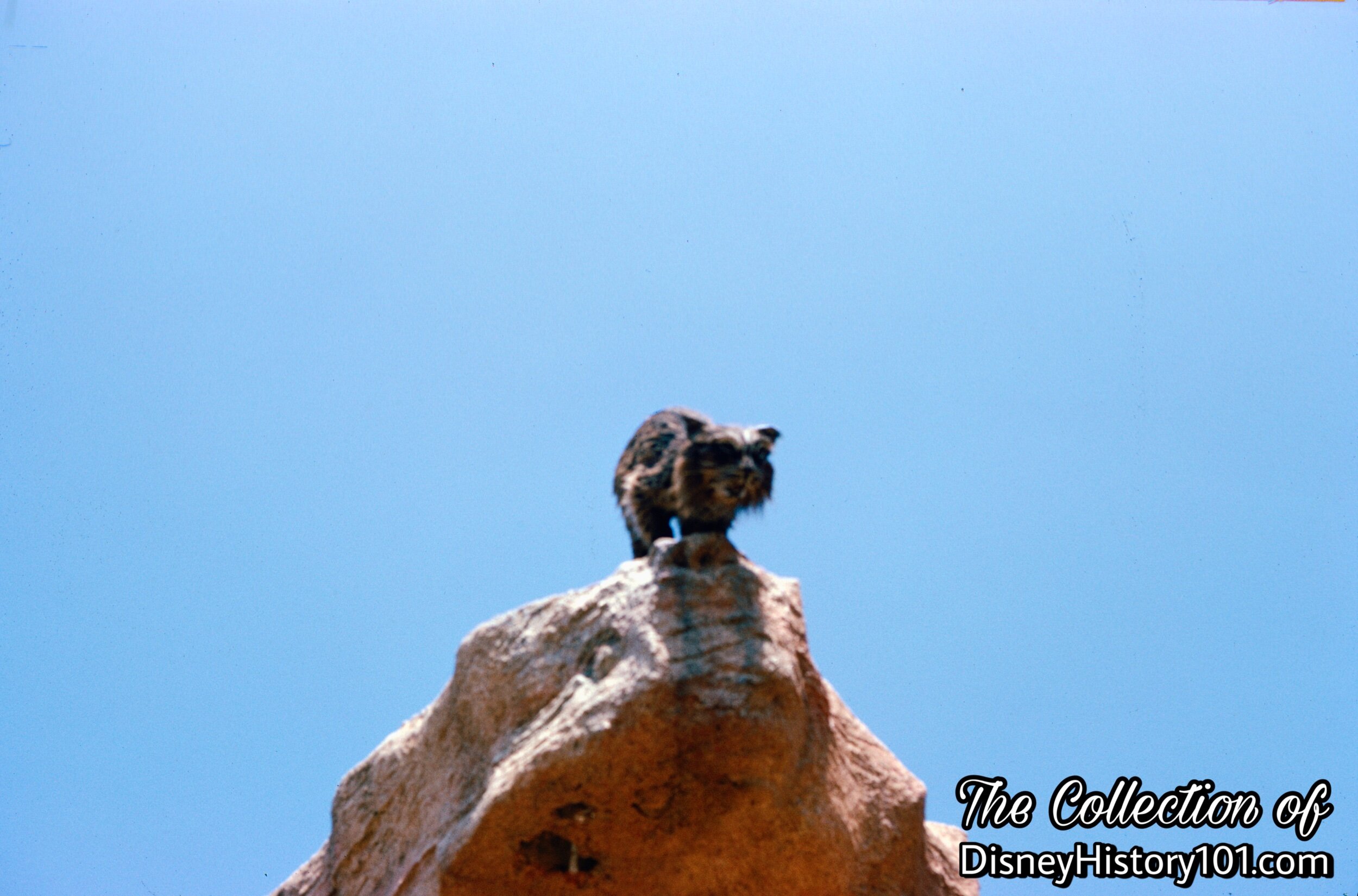
“Watch that wildcat, lady!…”
“Glad he stayed up there. We’ve known these critters to take on a full-grown deer, more than ten times their size in weight.”
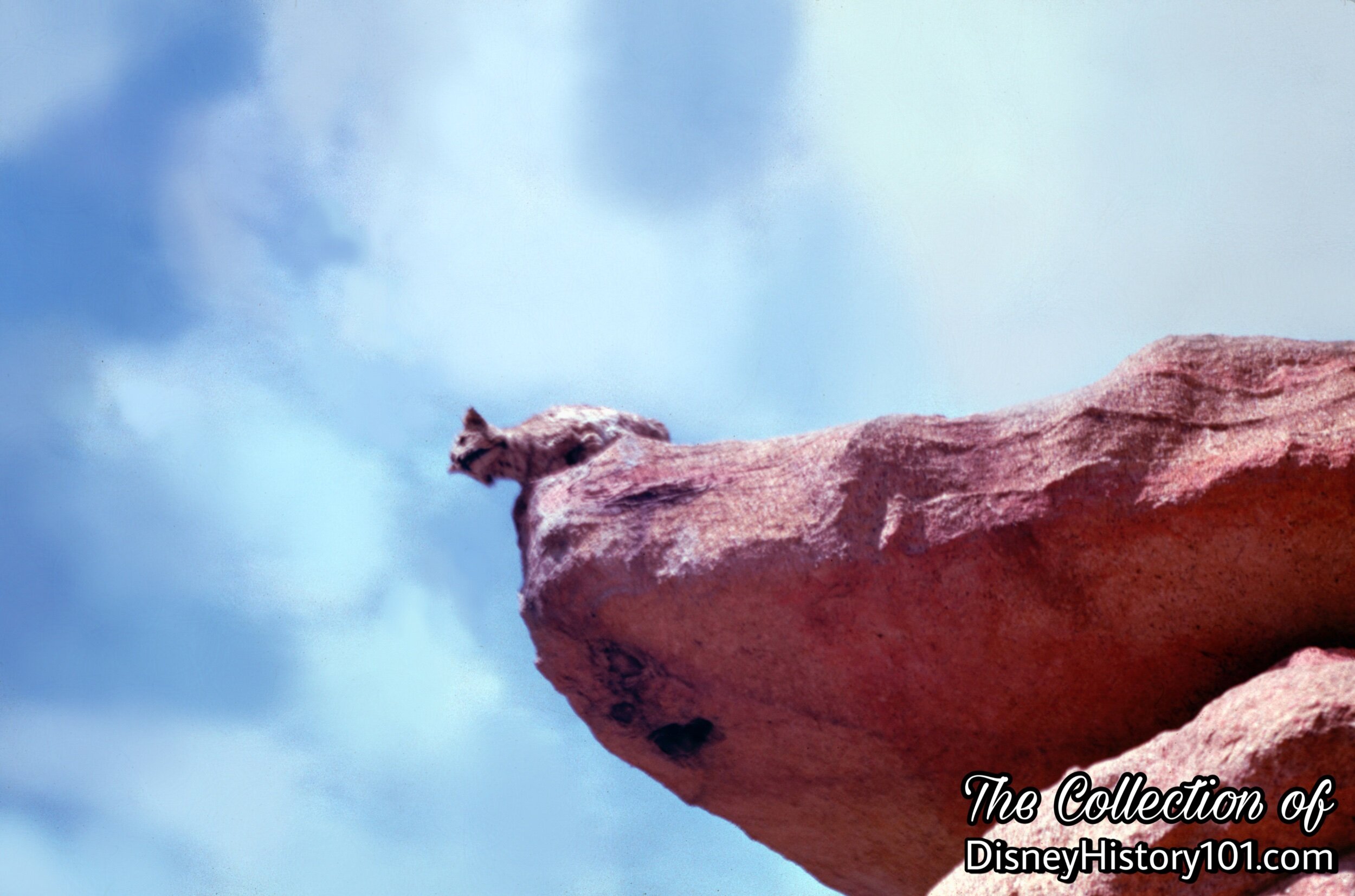
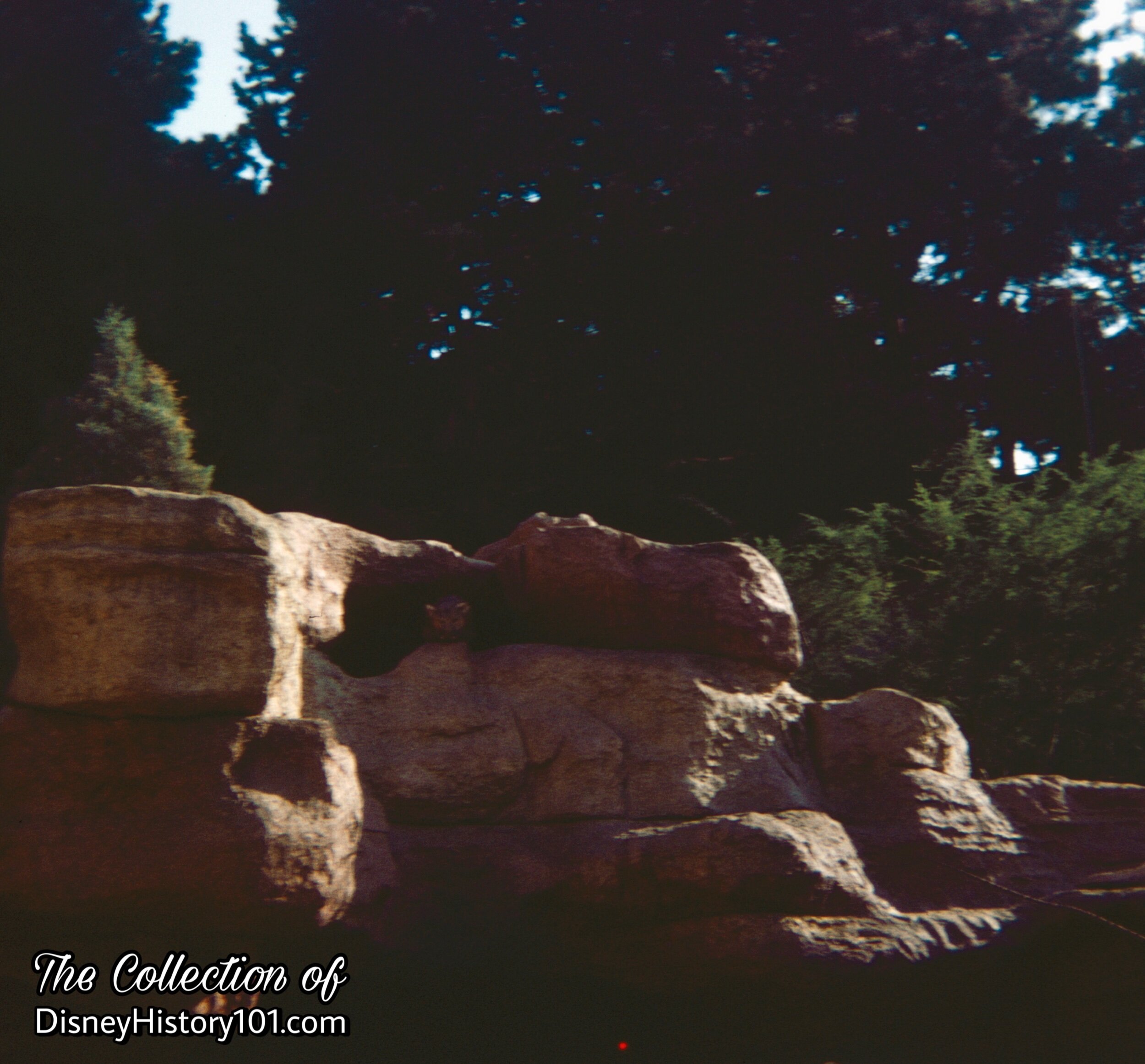
I’ve seen some four Mountain Lions in all of Nature’s Wonderland. It looks as if one lonesome Mountain Lion (or, “cougar” near the geysers) may have tracked us to the tunnel. Some Disneyland Cast Members around these Frontier parts have gone to naming him, “Charlie.”
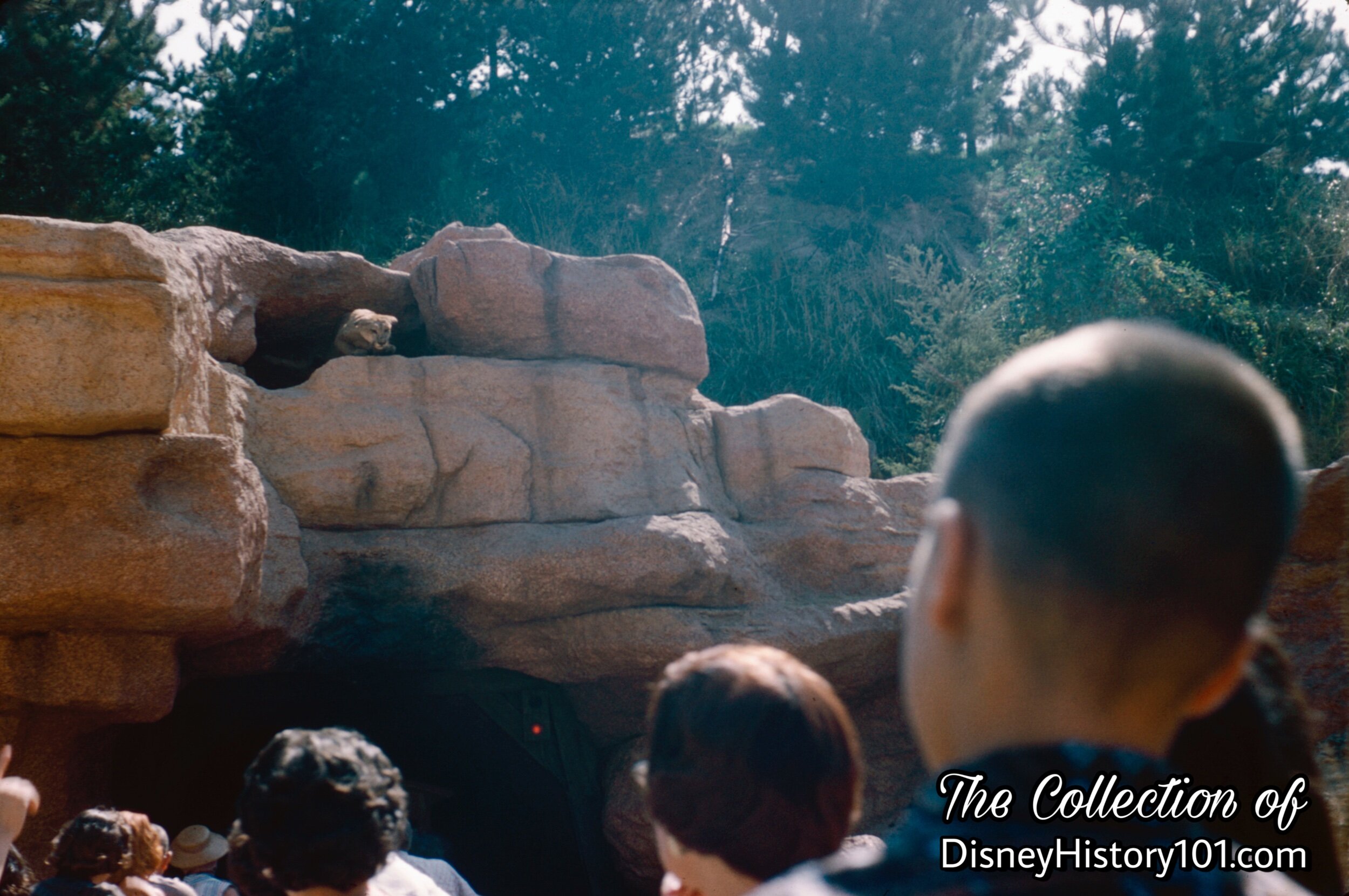
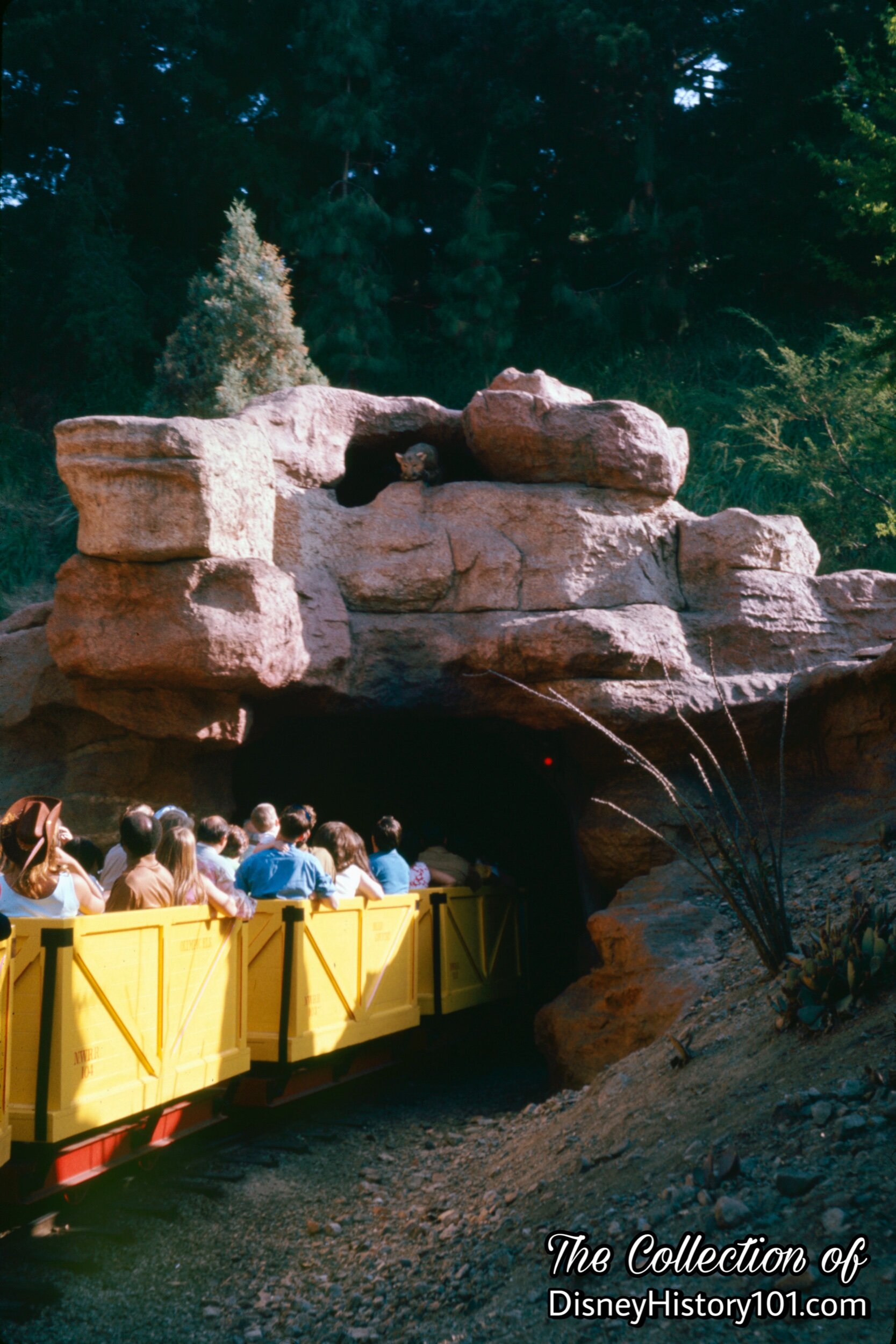
Well, it looks like we got the green signal to proceed inside the Rainbow Caverns. We’ll blow our whistle to alert any workmen or others who may be traversing the silver and gold lined caverns. Along our route, we’ll “pass bones and skeletons glowing in the natural light of the abandoned old mine, and cross a yawing chasm that once barred further exploration”, according to “News From Disneyland” (a press release document, published 1956). In the earlier years of the Rainbow Caverns, there was a many colored waterfall which “tumbles from great height in the Cavern’s weirdly lit interior to splash at the foot of the track right of way… the ‘Bottomless Pit’ and ‘River of Gold’ are other sights of the Rainbow Caverns,” according to The Disneyland News (Vol. 1, No. 12 ; June of 1956). Now guests had the opportunity to see other formations - Bridal Veil Falls, Paint Pot Falls, Red Devil Falls, Angel Falls, Geyser Grotto, Dance of the Seven Sisters, Rainbow Falls, and the Witches Cauldron.
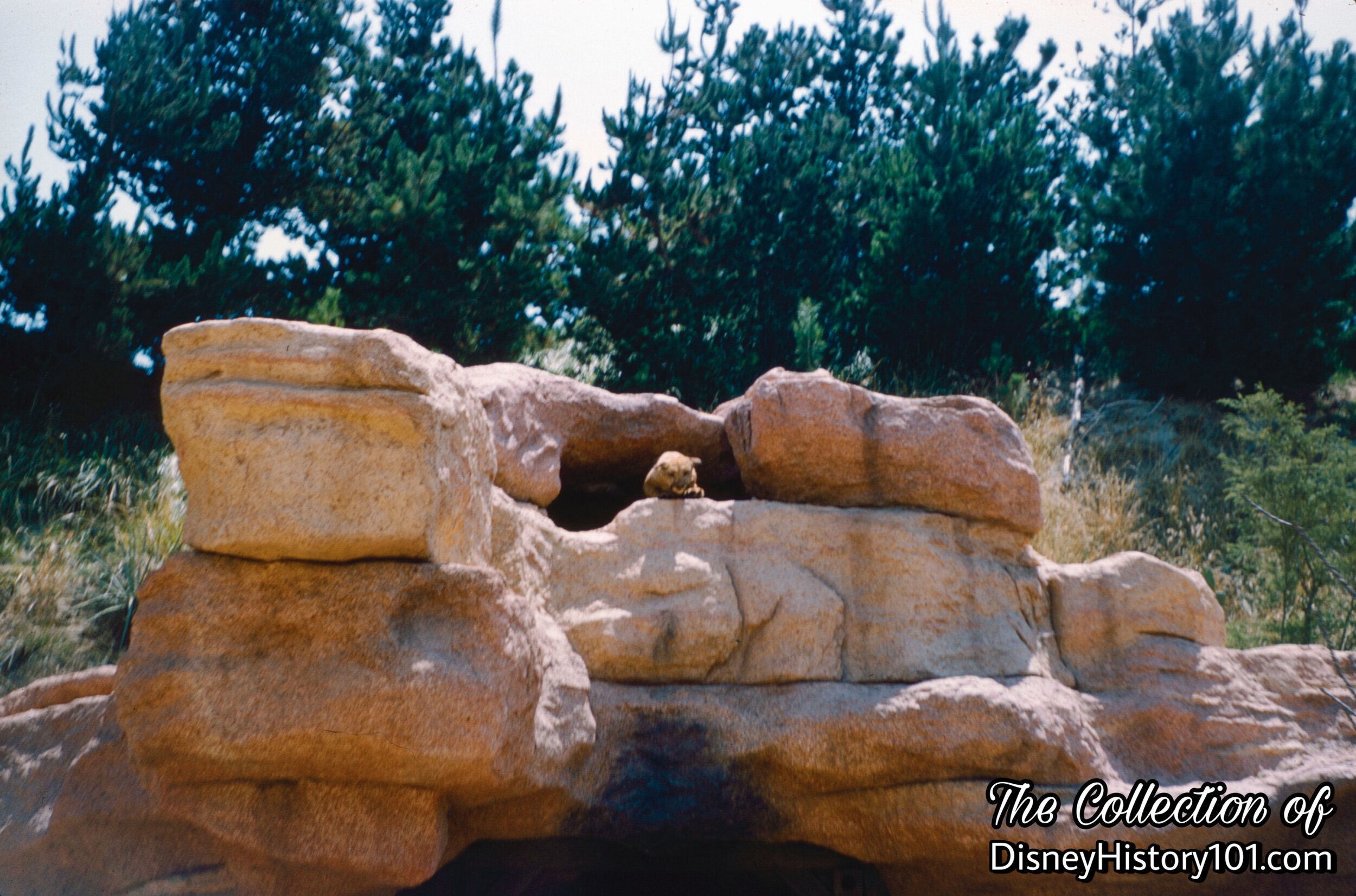
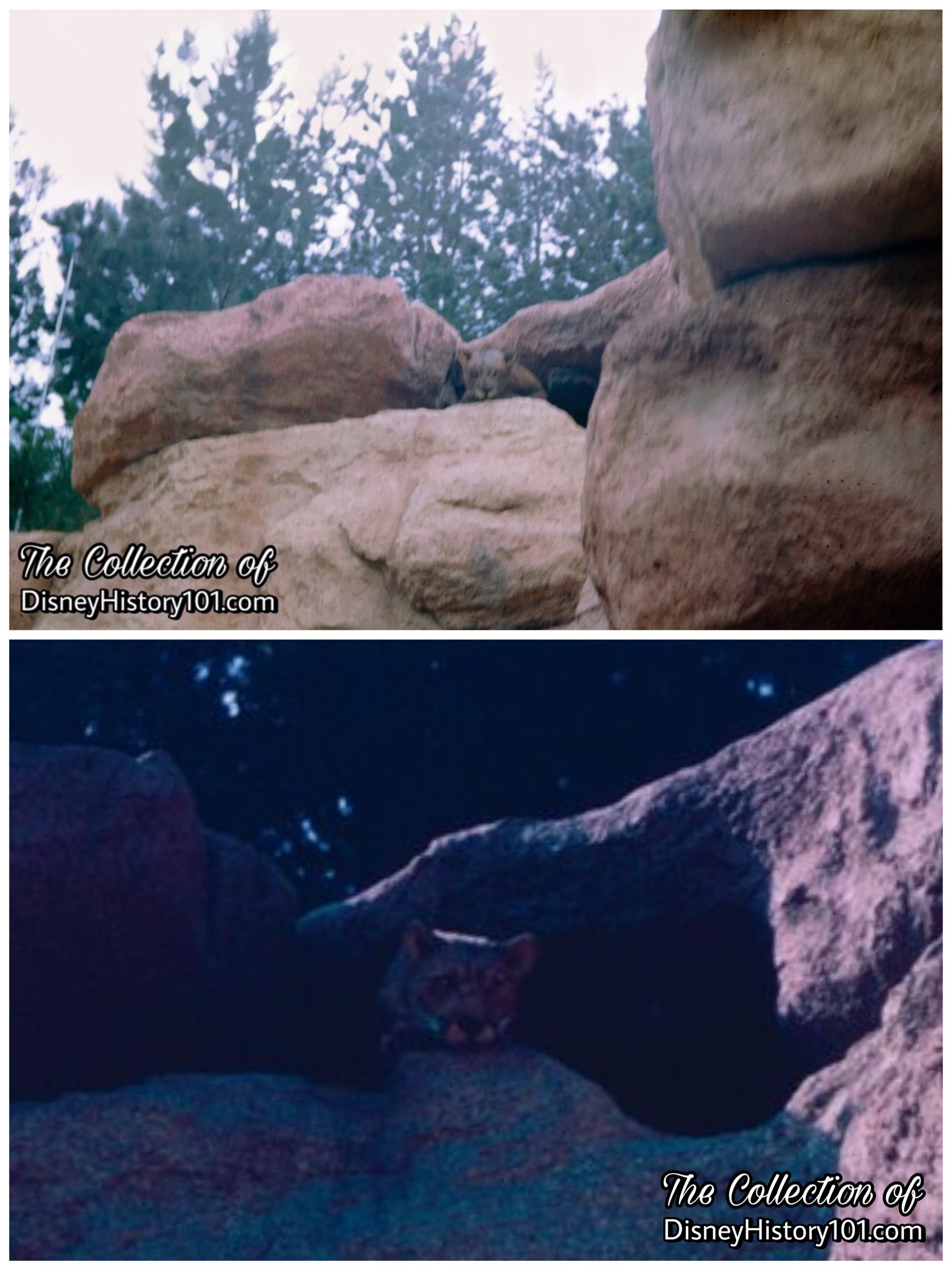
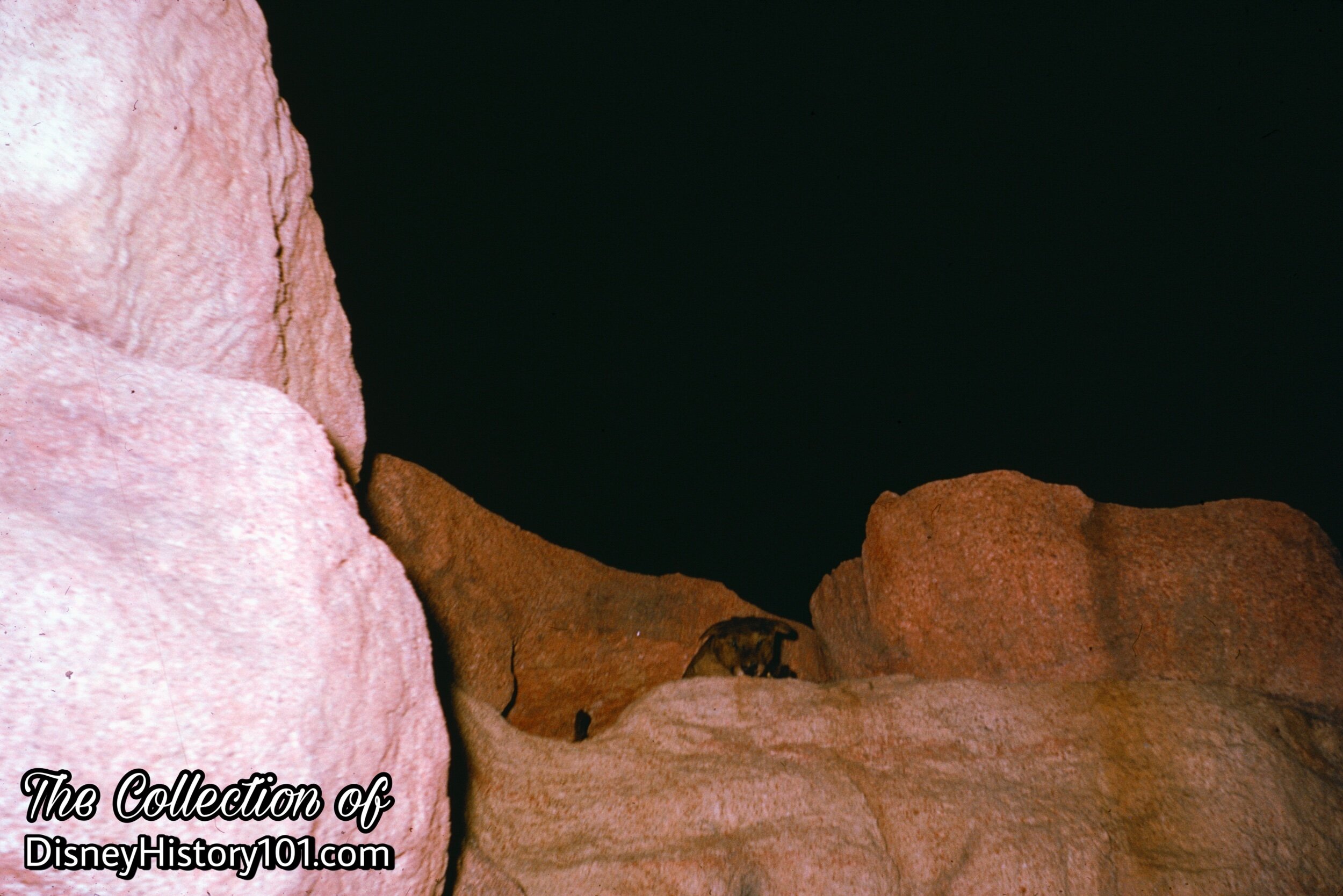
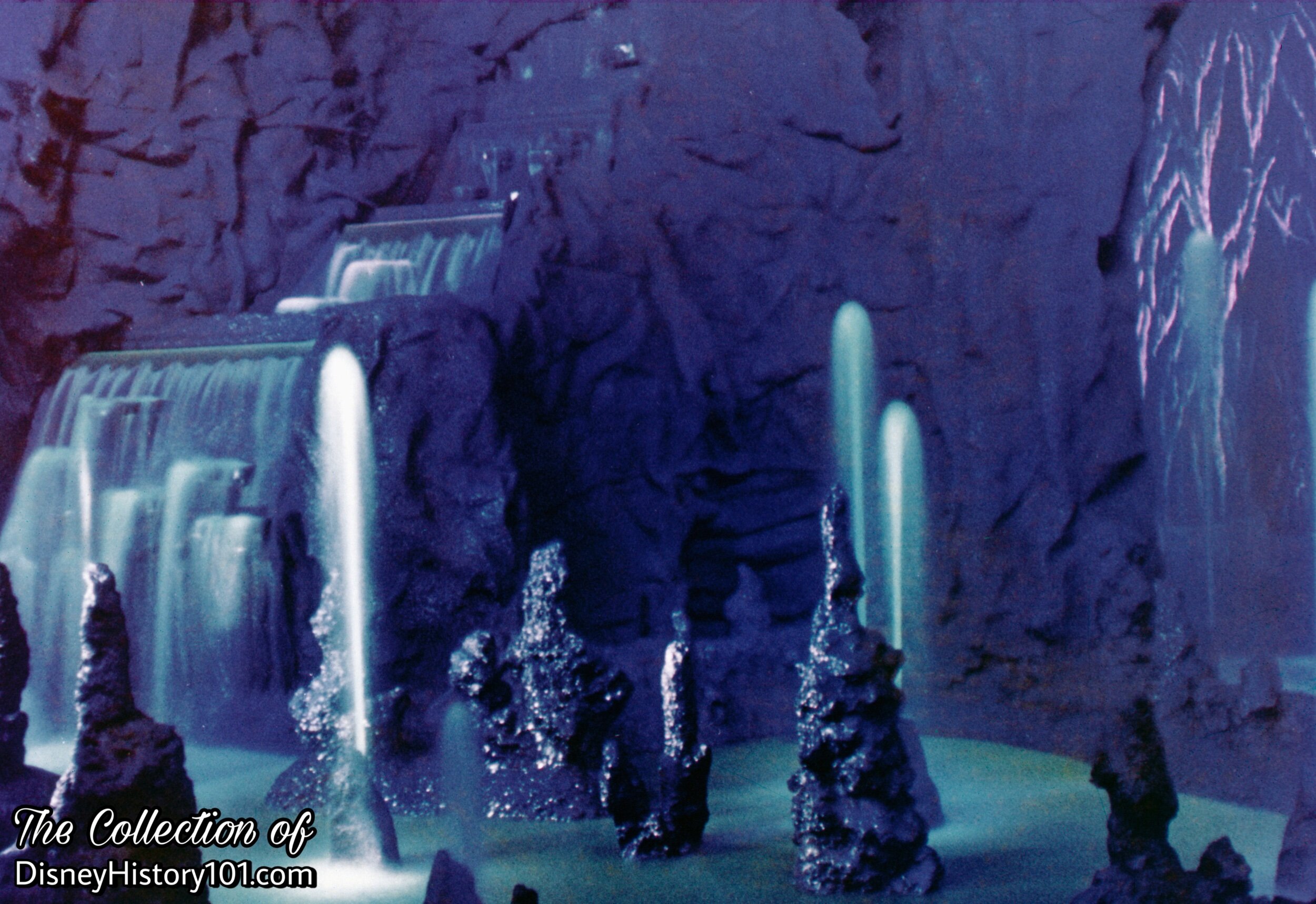
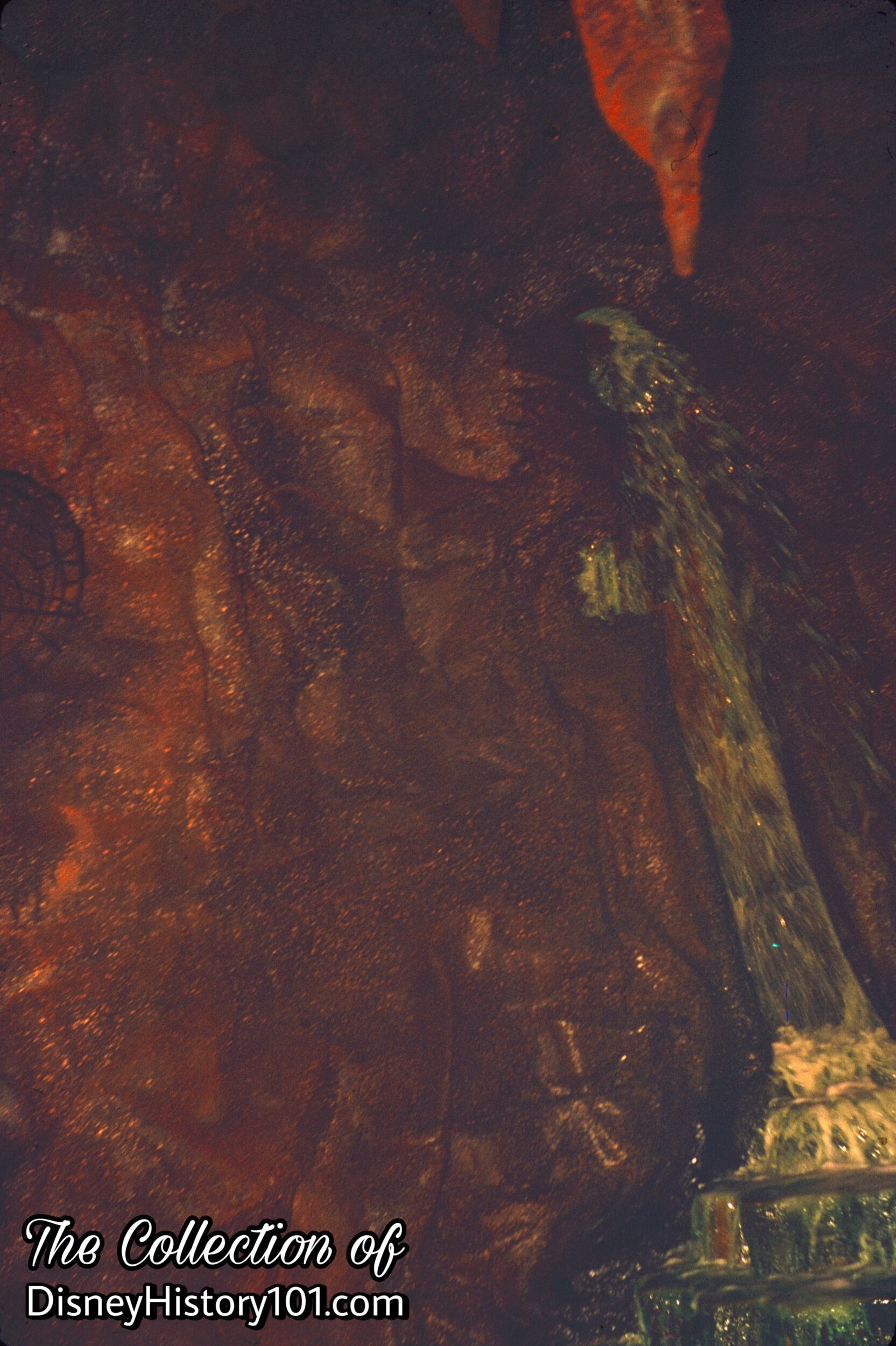
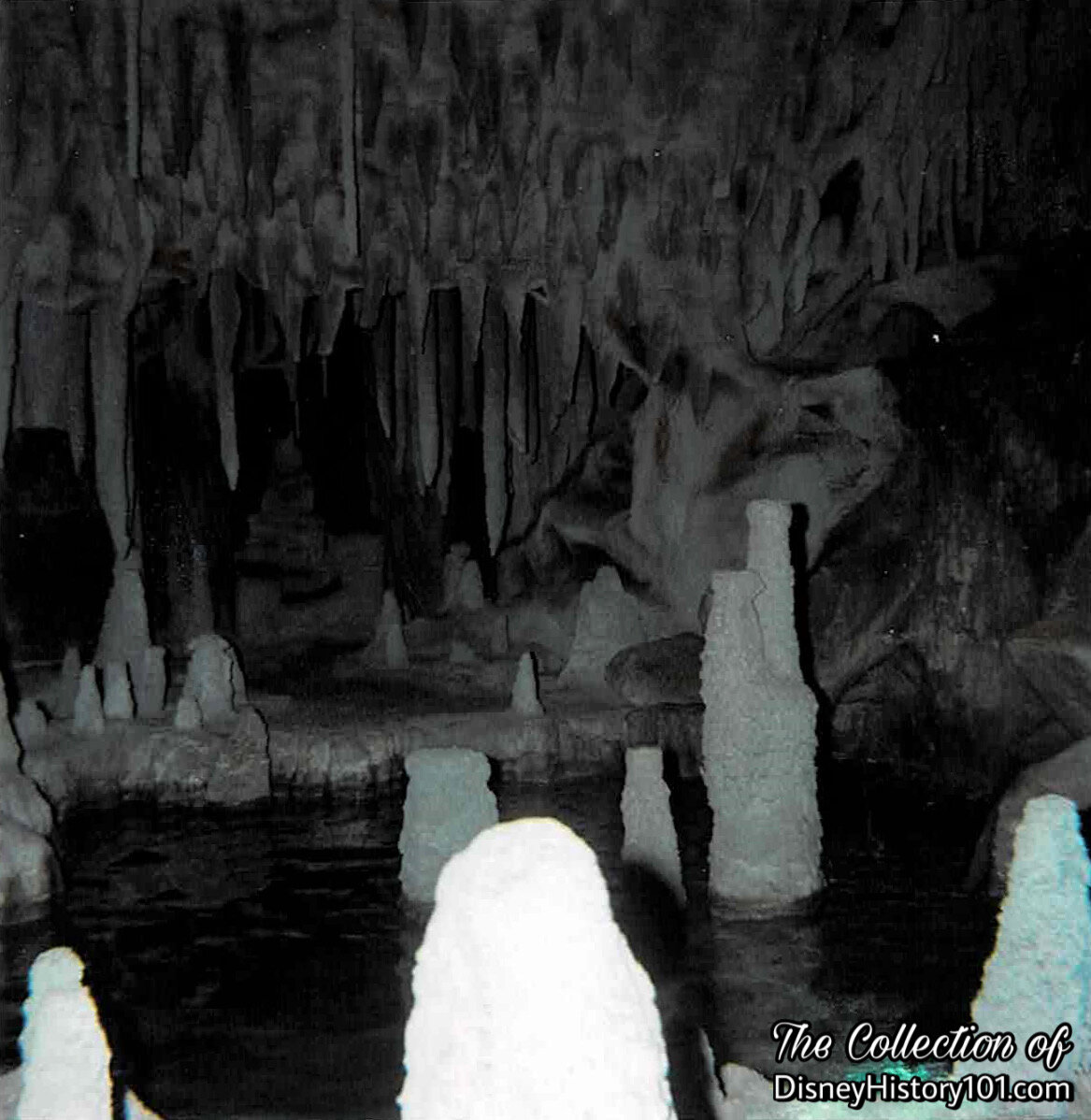
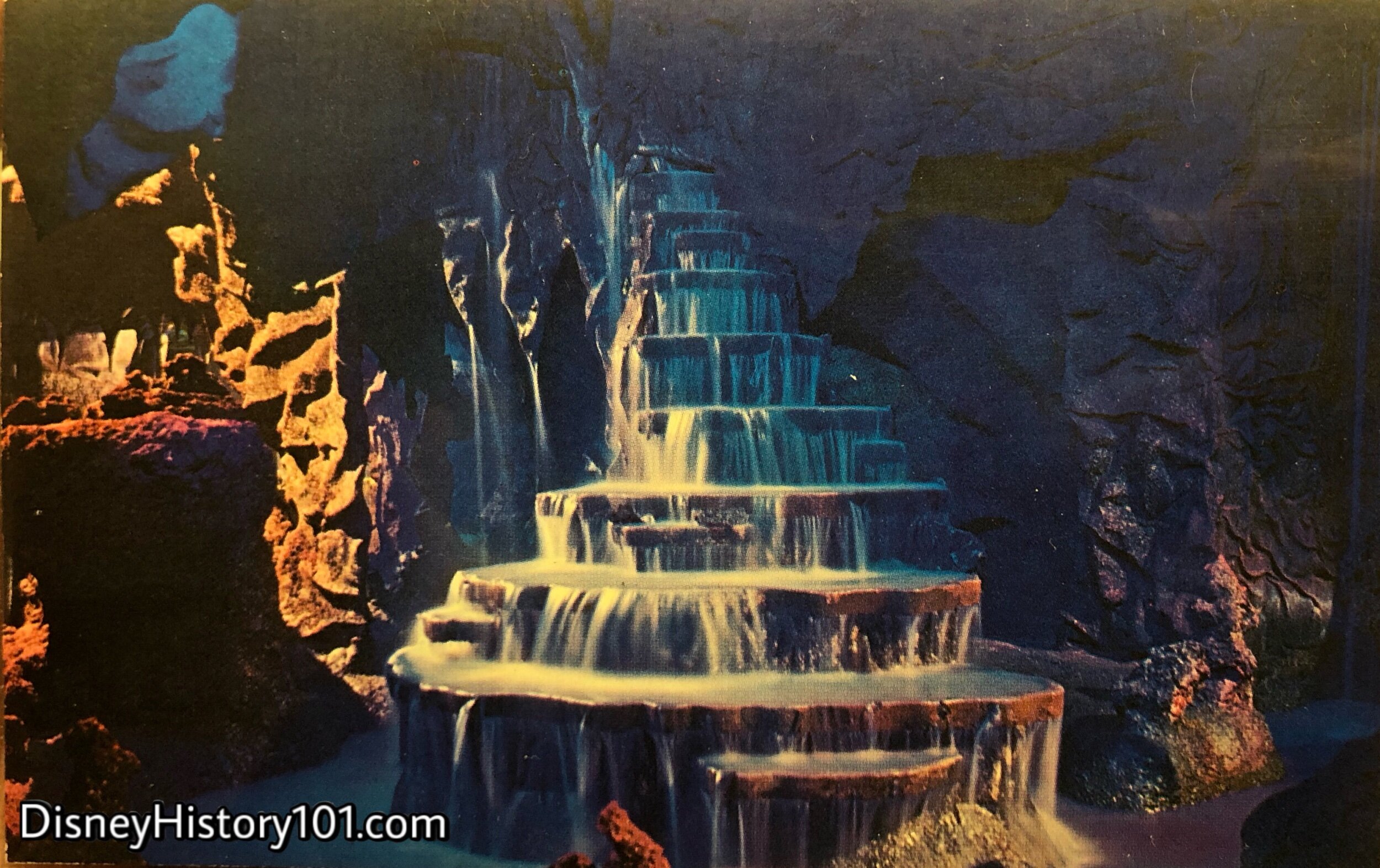
“The Rainbow Ridge mine train tunnels deep into the beautiful Rainbow Caverns where surging waterfalls and multi-colored stalactites and stalagmites are viewed in breathtaking splendor.”
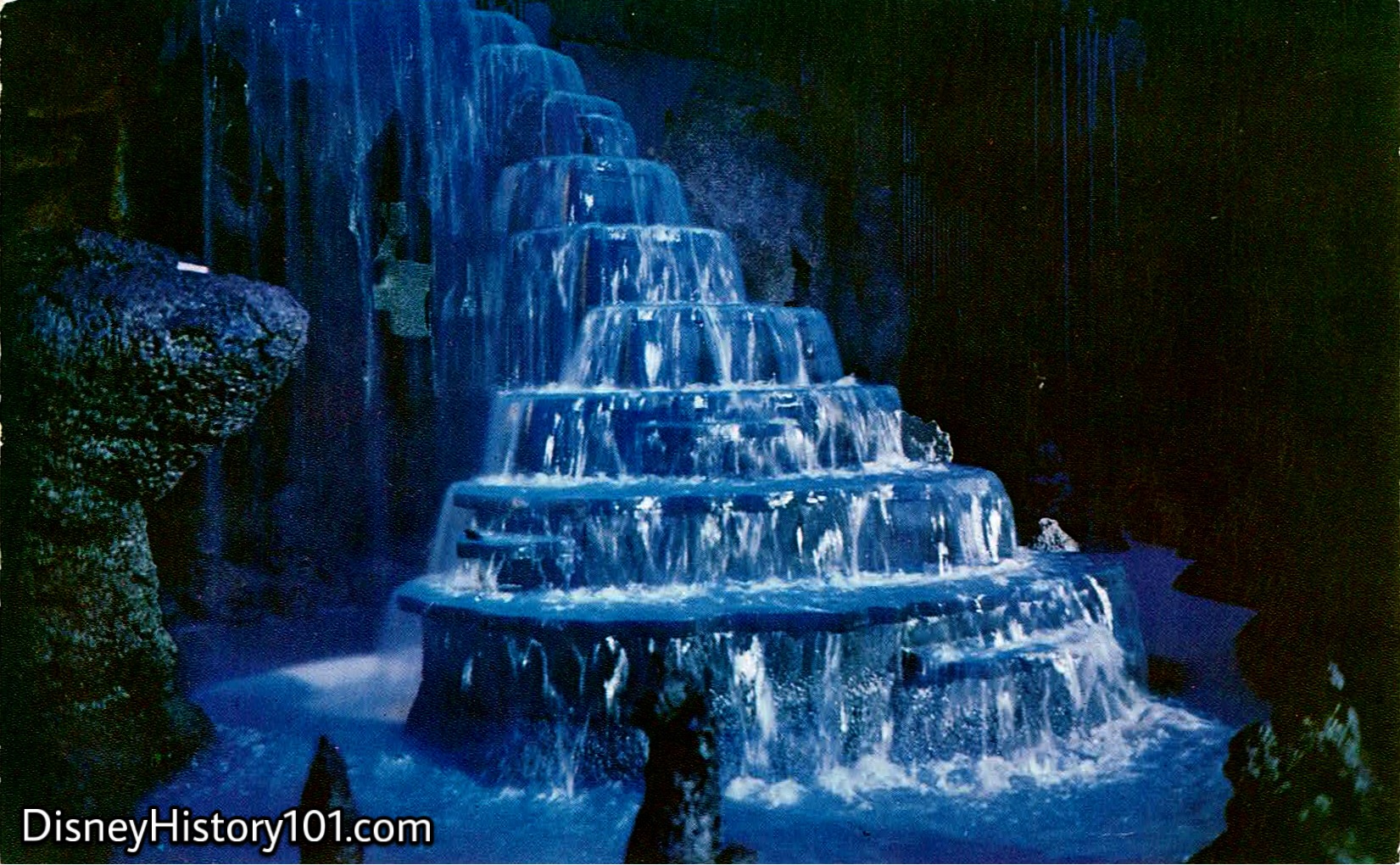
“The Rainbow Caverns”
“Now we’re going deep into the earth to view the dazzlin’ Rainbow Caverns. You’ll see giant stalagmites, stalactites ‘n colorful falls on ever side. Say, if yuh look real careful, you’ll see Geyser Grotto ‘n even the Witches Cauldron…!”
According to Disney News (Spring, 1985), “A designs challenge posed by the addition of the Mine Trains through Rainbow Caverns’ became a springboard to one of Disney’s creative axioms. After winding through the desert terrain, the ol’ prospector’s train was to end up in a cavern of multicolored waterfalls, iridescent pools and geysers.” The original Rainbow Caverns featured all sorts of “true-life-like” formations. There was the golden Bridal Veil Falls, Red Devil Falls (red water pouring over rocks shaped like a devil), the Witches Cauldron… (which had red water falling over rocks shaped like an old witch, and then into a bubbling pot below), Paint Pot Falls, Geyser Grotto (spelled “Gyser Grotto” on a directional sign in the Caverns), and the falls of the Dance of the Seven Sisters (which gave the appearance of women dancing).
All the “Cavern Building” dark ride features were created by Claude Coats with schematics (like elevations) drafted by Sydney Louis Lev. The Second Edition of “Disneyland - The Nickel Tour” preserves images of Claude’s colorful concepts and developmental designs on pages 133 & 134. “Claude first set out designing a series of caverns, set deep in the mountain. He began by using an interesting asset the Disney Studios still had lying around... some leftover set pieces previously used in Walt's live-action feature film, 20,000 Leagues Under the Sea. (The rest of the sets wound up in Tomorrowland.) … Claude employed a crew of carpenters for several weeks, nailing up lumber and welding metal, turning the random set pieces into believable caverns. Before long they would be reincarnated as a part of Disneyland history.”
Of course the most spectacular of these water features was the multicolored Rainbow Falls - a magical effect that did not come about by some mere “happy accident.”
“‘I was trying to work out a rainbow-colored waterfall for the Mine Train ride,’” said artist designer Claude Coats. “‘I thought I had the thing working pretty good.’” At this time, Walt “called on a noted scientist to determine if it could be done.” This scientist’s name was Heinz Haber, a colleague of Werner Von Braun’s, and he proceeded to prove that the waters would splash together, and “within a week all of the colors would turn to gray,” according to Disney News (published Winter 1967-1968). Claude continued, “I told Walt what Heinz said about the rainbow waterfall being impossible to bring off. He just winked at me and said: ‘It’s kind of fun to do the impossible.’ So I started working about twice as hard and figured out a way to make it work.” [“Insights” by Steven Hulett ; “Disneyland 25” Advertising Supplement, January 20, 1980] The attraction with its show-stopping pinnacle opened within months, and guests could spot six vibrant colors! Some of this success can be attributed to Walt Disney who had formed a habit of always “exploring new paths and experimenting with new technologies.” It was said that “Walt, who seldom turned away from a challenge, merely impressed upon his staff, ‘its kinda fun to do the impossible,’” according to Disney News (Spring, 1985).
Yes, “approximately 270,000 gallons of water per hour are circulated to create the seven multi-colored waterfalls seen in the Rainbow Caverns in Frontierland. This is at a 40 foot head,” according to “A Complete Guide To Disneyland,” published 1957. This was so impressive that the first eight Tour Guides were given a Backstage Tour of the various pumps and dye processes to help them understand how the colors were maintained. Those colors truly never faded and this was further proven by the comments recorded in publications. For instance, three years later (during the summer of 1960), “new lighting and creations in color and unusual formations of stalagmites and stalactites have been added to the seven multi-hued underground waterfalls which cascade into boiling pools,” according to Vacationland, (Summer, 1960). Two years after that, the Guide Tour Script (1962) added : “It might interest you to know that the colored waterfalls are created through the use of fluorescent dyes in the water and black light. An elaborate … [six-pump] system [which] circulates over 43,000 gallons of water per hour.”
In 1963, the author of one sanctioned “Disneyland” publication referred to the creation of the effect (on the eve of another rehabilitation) stating: “Seemingly ‘impossible’ things are done as a matter of course at Disneyland. As an art director explains, the scientist who claimed that the design for Rainbow Caverns was not possible was absolutely right. But with a little persistence and ingenuity, a lot of baffles to separate the streams of colored water, and a lot more luck, the impossible project turned out to be feasible. And so, seven years after it was first opened at Disneyland, Rainbow Caverns is under-going extensive changes. Walt Disney has decided to make the underground attraction even more spectacular. And, while he is at it, he may add a color or two.”
Finally, ultraviolet lamps were used in the attraction to give a glowing effect to the fluorescent paint. These new Show Quality enhancing fluorescent effects were so impressive, that scientist Edmund A. Braun drew attention to them in his book “Black Light Creates Fascinating Fluorescence” (published 1968) : “World-famous Disneyland makes use of fluorescence in its ‘dark’ rides…Disneyland’s Mine Ride also uses black light and fluorescence to great advantage.” By 1974, one quart of ultraviolet paint was still being used to keep the color balance just right, according to Cal Harnetiaux (Disneyland Paint Department). It is clear that by that time, the rainbow of colors hadn’t become one “authentic water-color gray” but continued to be distinct.
Nightly these pools and fountains were cleaned.
Now, if guests could actually explore the “backside” of the magnificent Rainbow Caverns, they would discover several necessary areas, including various pumps on the Fantayland side, a Mine Train Storage Area, the Machine Shop, Sub Station No. 4, and even Disneyland Offices.
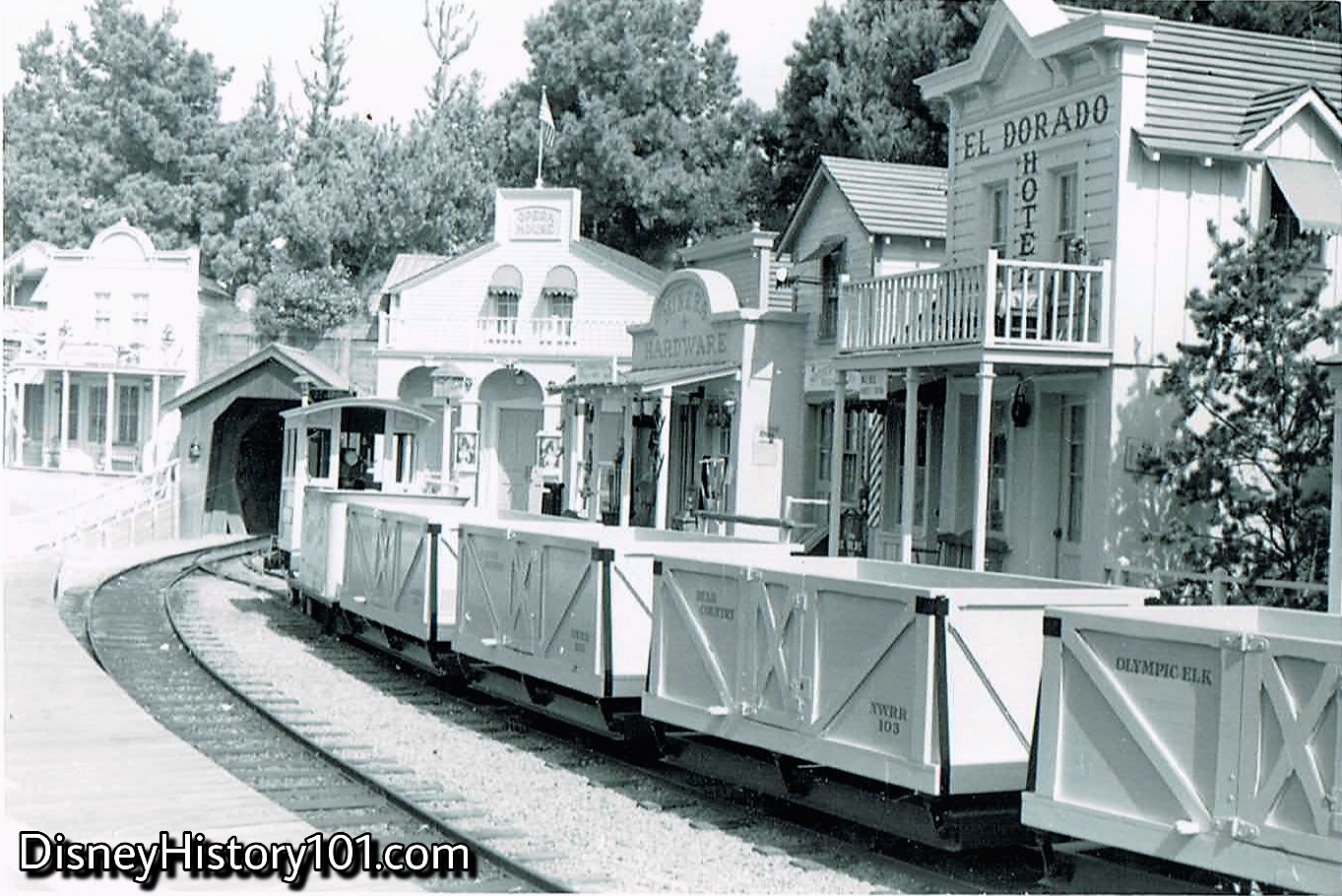
“Well…I see we’re comin’ back to Rainbow Ridge again.”
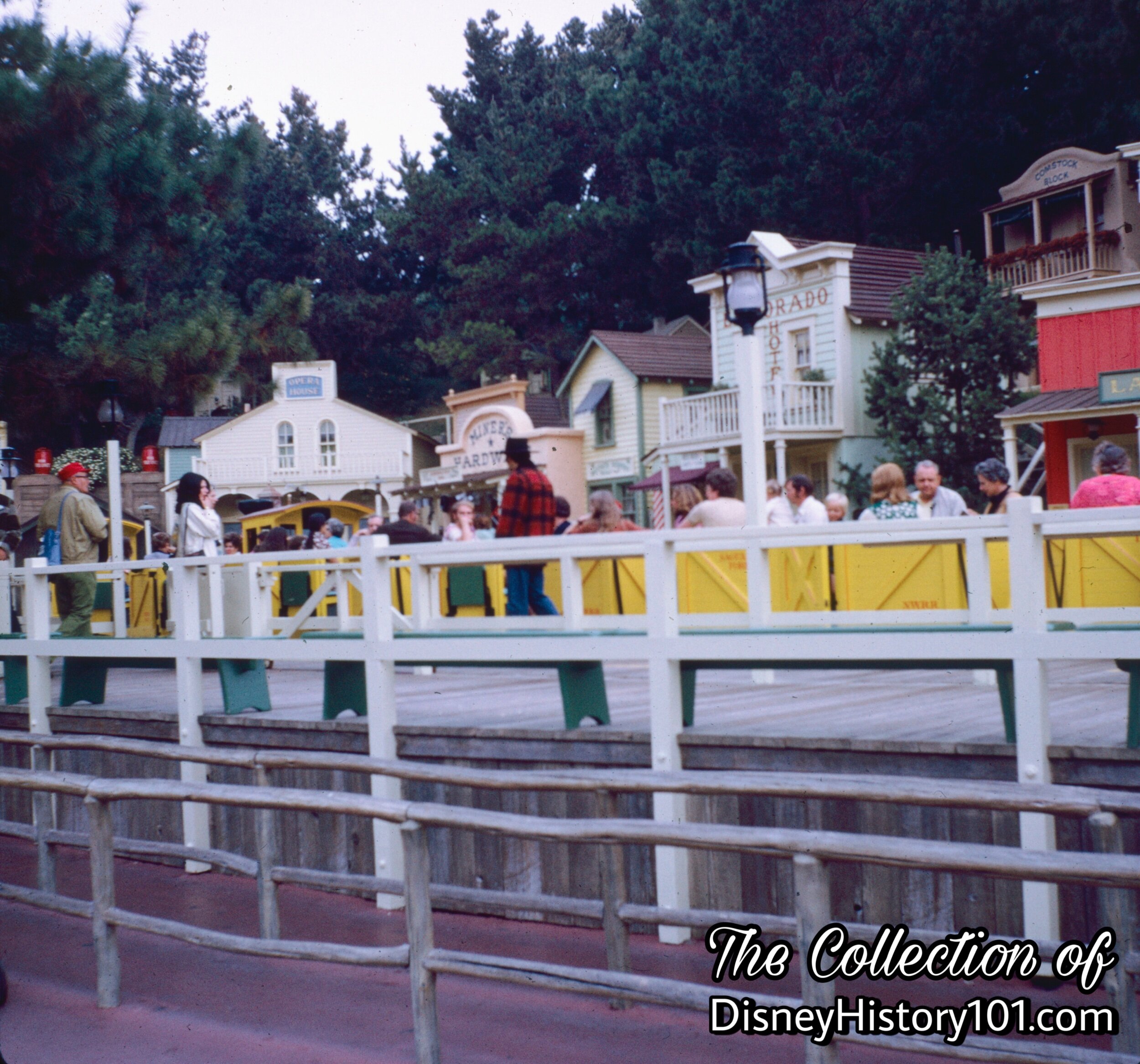
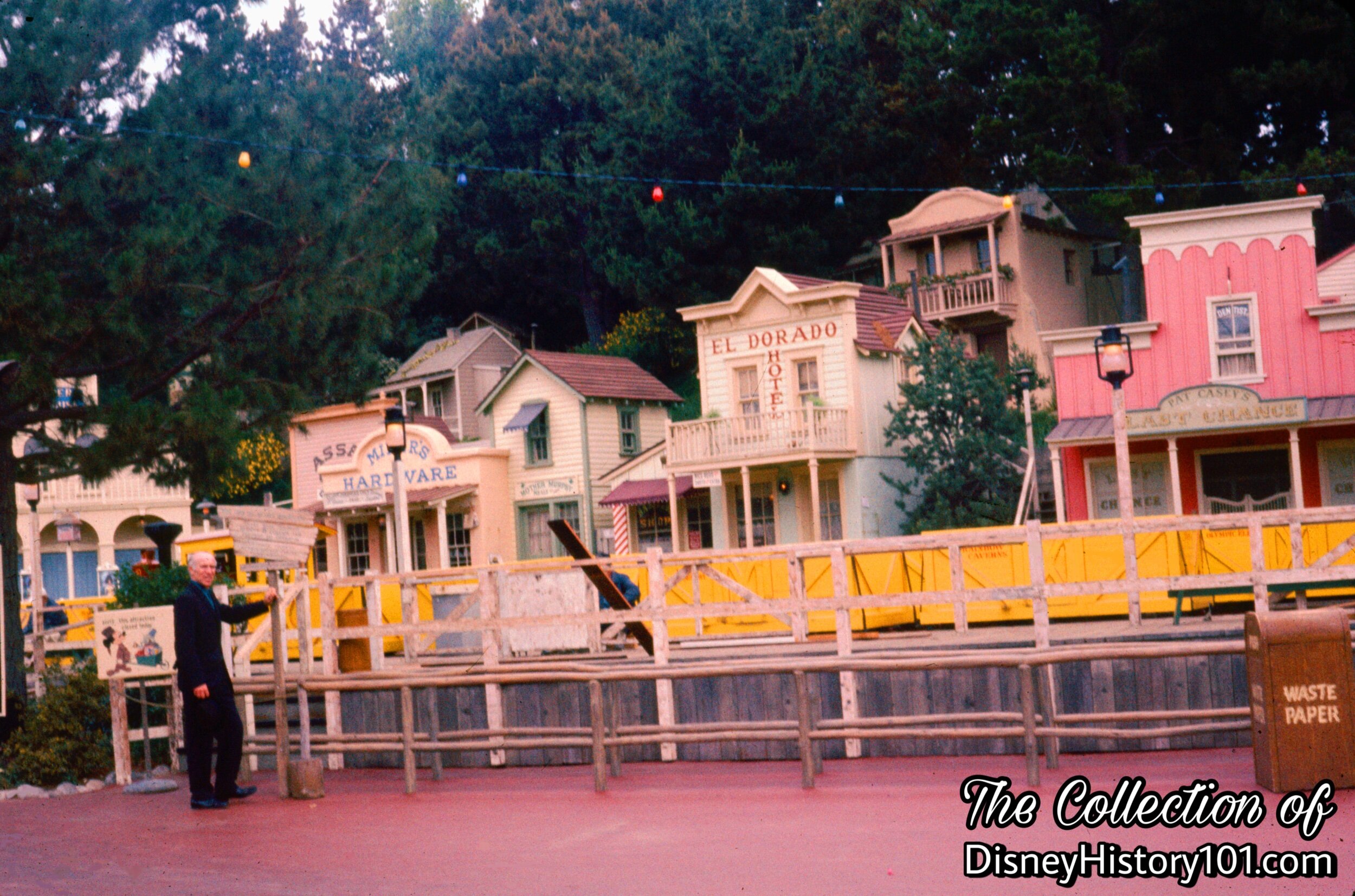
Regular rehabilitations led to freshly repainted trains and even a new platform (pictured above, c. 1966).
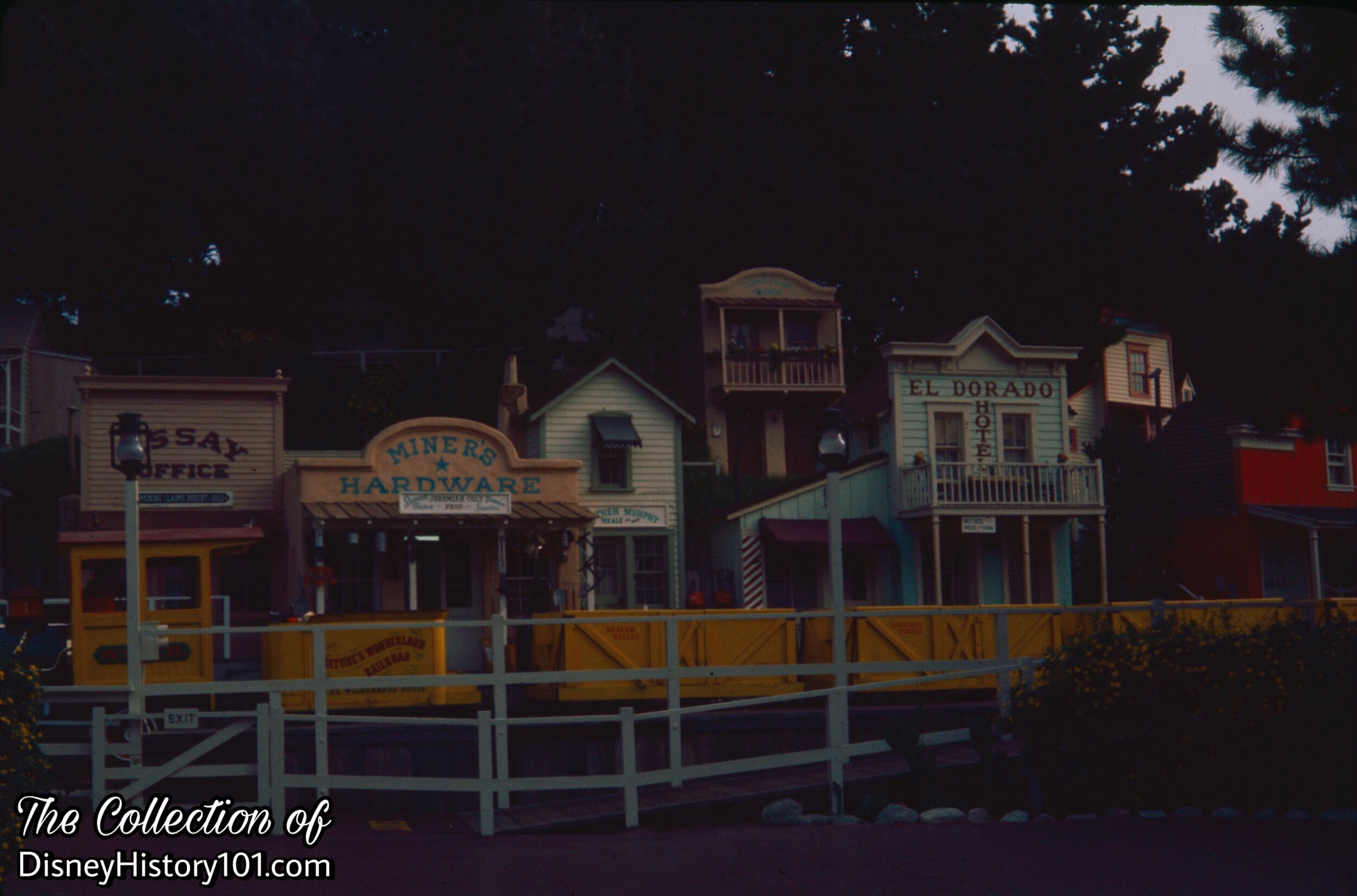
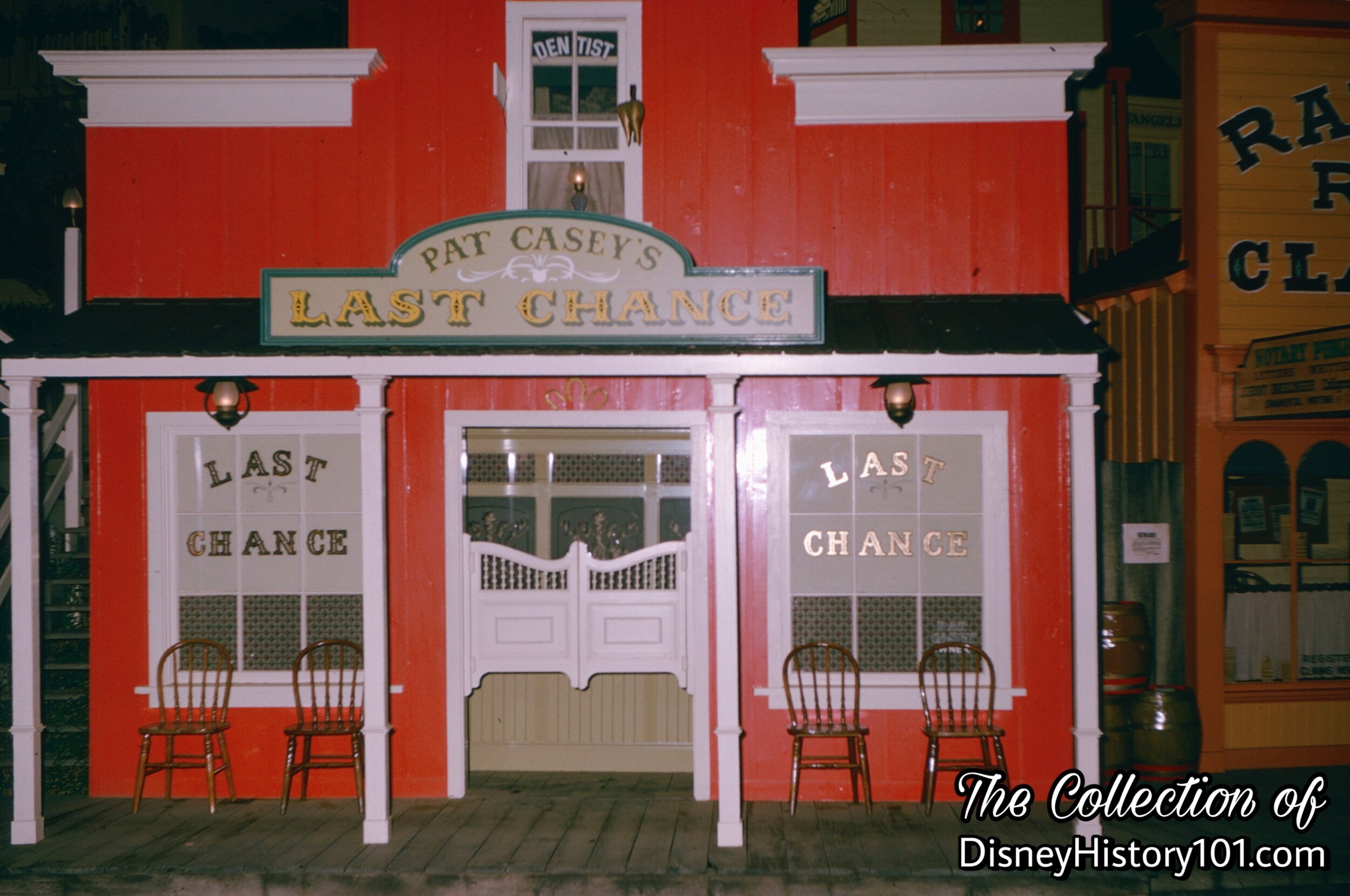
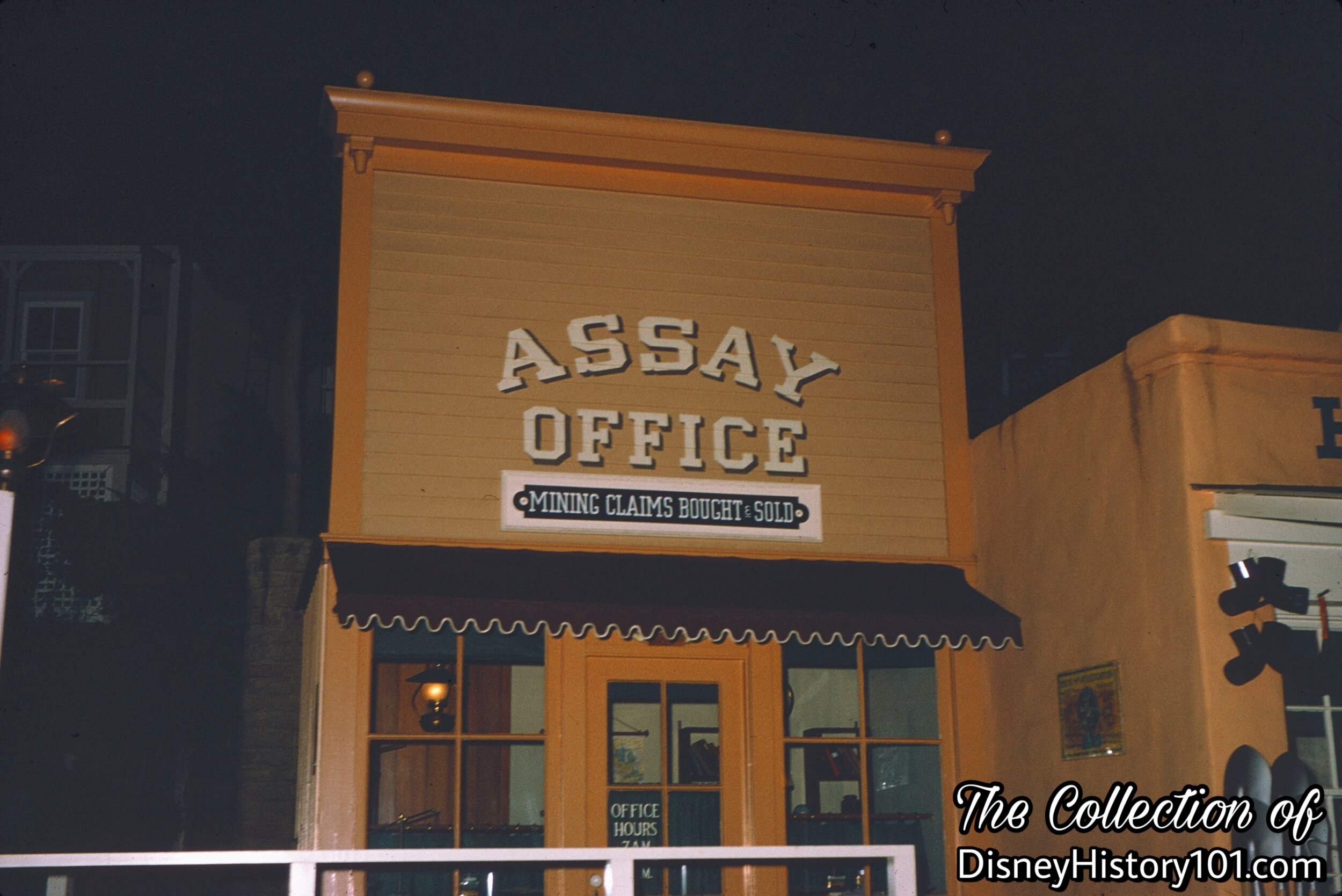
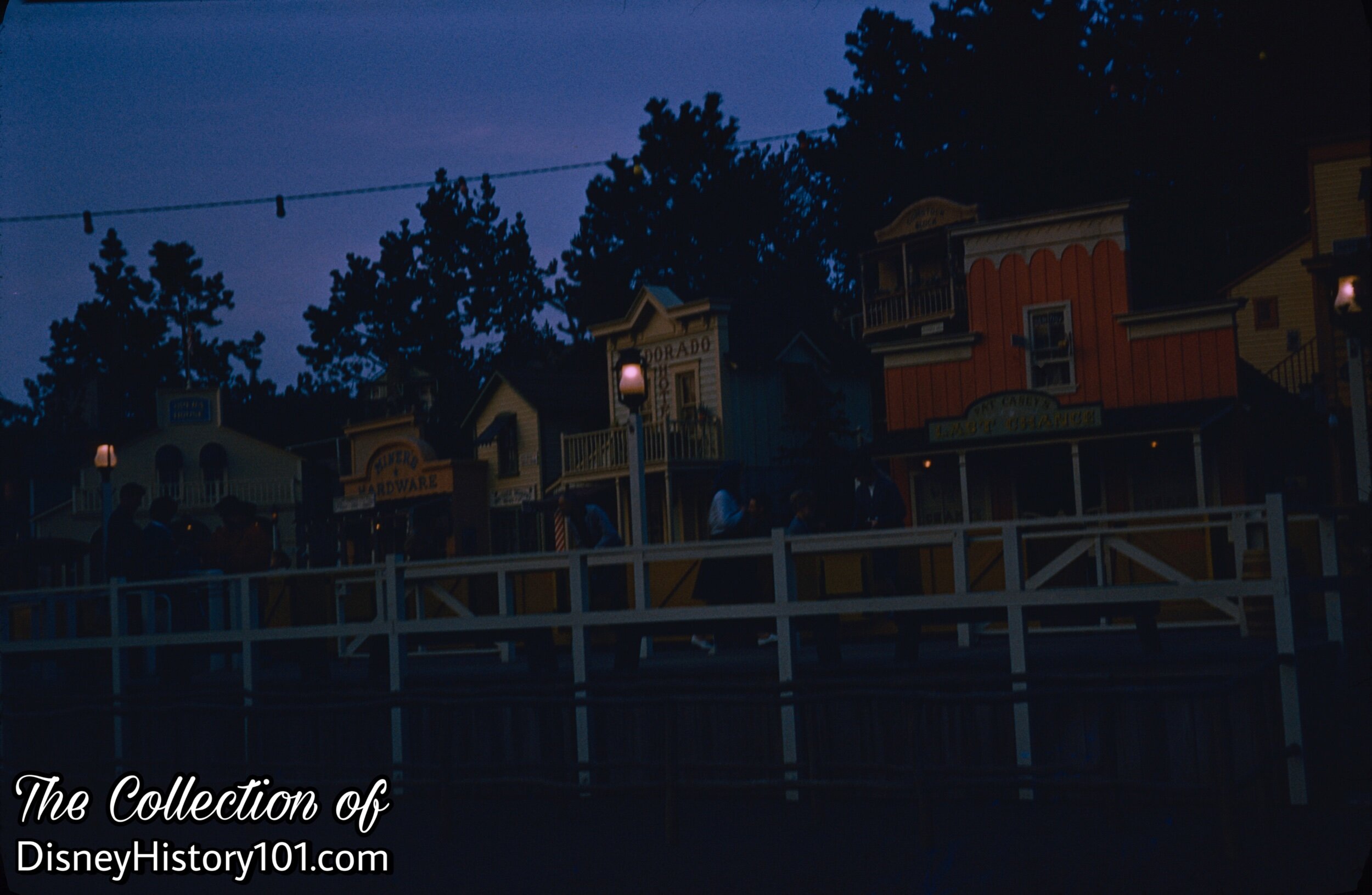
It looks like the sun is setting over the town of Rainbow Ridge and Natures Wonderland. Y’know, dusk is one o’ the best times to spot critters in their natural habitat!
Character lighting was themed to enhance the overall appearance and complement the interior, such as a chandelier or kerosene lamp. These add to the show, but don't necessarily create enough illumination for operation.
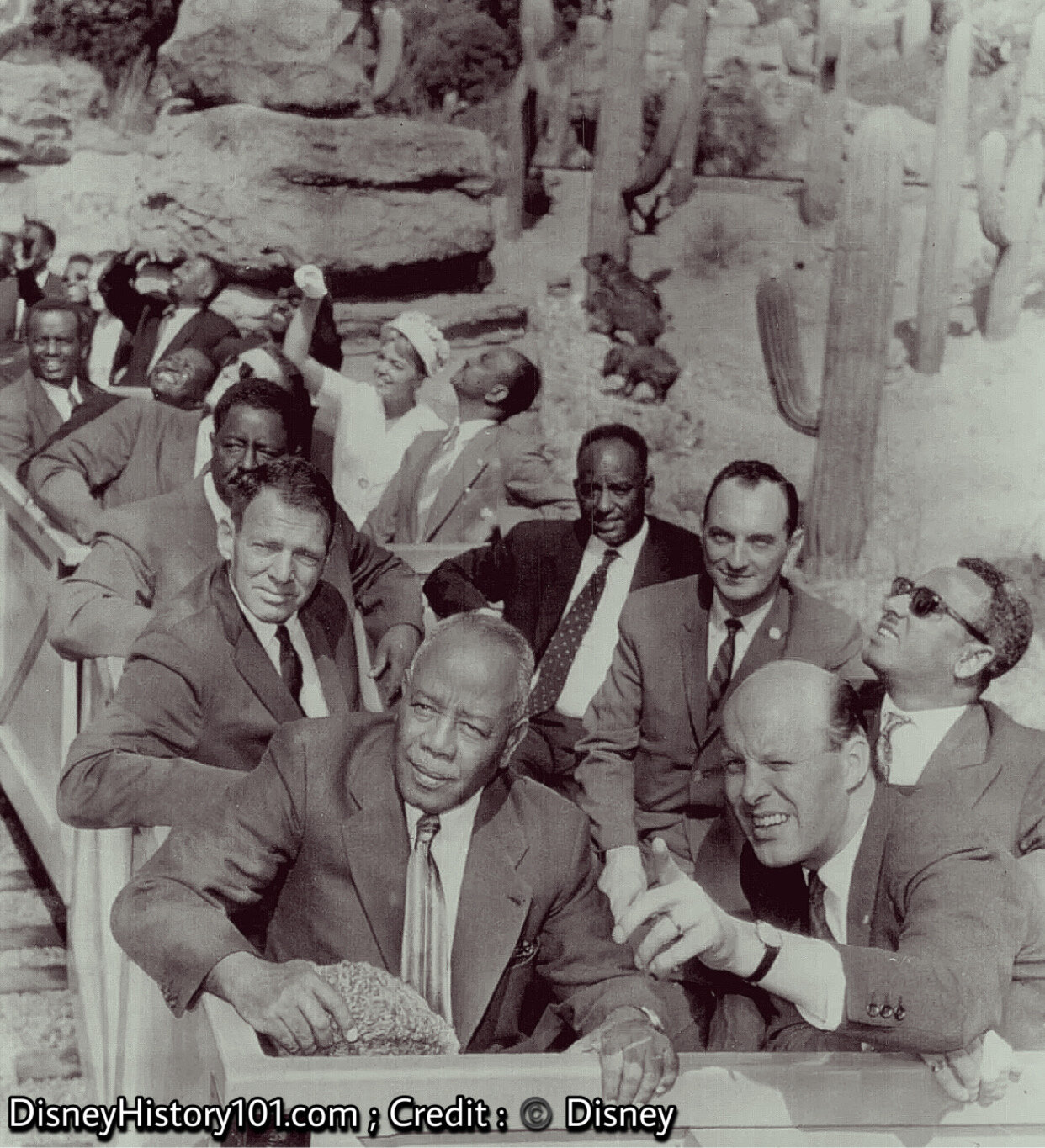
Quite a few notable events occurred around the town of Rainbow Ridge and Nature’s Wonderland. First, Frontierland personality Black Bart usually attempted to escape into the outskirts of Rainbow Ridge before being foiled by the local law enforcement. The latter was part of a concept (popularized through World’s Fairs, like Expo ‘67), which Walt pioneered since Disneyland’s earliest days - entertaining queue lines with live performers. Fantasyland had its life-size characters, both Adventureland and Tomorrowland had their live musical entertainment, and Frontierland had its gunfighters near the town of Rainbow Ridge! The area also served as a “set” of sorts, home to a Character experience or meet and greet with Black Bart, the Sheriff, and other “Gunfighters.”
“Walt Disney’s Guide to Disneyland” books (published for 1960) contained inserts advertising the new adventure. As the Mine Train Through Nature’s Wonderland was one adventure often included along Disneyland Guided Tours and V.I.P. Guided Tours of Disneyland, many notable guests recall experiencing this adventure!
The first President of Sudan visited Disneyland (on October 8th, 1961). “As a pack of Peccaries move though the Living Desert (in the background), President Ferik Ibrahim Abboud (left foreground) and his party look at the sights in show, from the Mine Train ride at Disneyland. Showing Abboud the points of interest is Henning Bodenhoff (right foreground) of Disneyland’s staff.”
(Credit : UPI Telephoto)

Occasionally the town of Rainbow Ridge was utilized as a stage for filming (but more commonly) performances. On Wednesday afternoon (March 21,1962), Ben Harris “met with the Universal Pictures Survey Group and conducted them on a three hour tour of the Park in preparation for [their] forthcoming film.” Owning to this, both a Mine Train and the town of Rainbow Ridge can briefly be seen in the memorable and comedic chase scene of “40 Pounds of Trouble”, starring Tony Curtis (released 1962). Pictured above, Tony Curtis removes a mushroom costume near the Mine Train Through Nature’s Wonderland Queue.
The Mad Mountain Ramblers performed from a stage set up in this area during Grad Nite 1964. During the summer of 1966, Hearts and Flowers performed near the Mine Train from 1:00 PM - 8:00 PM.
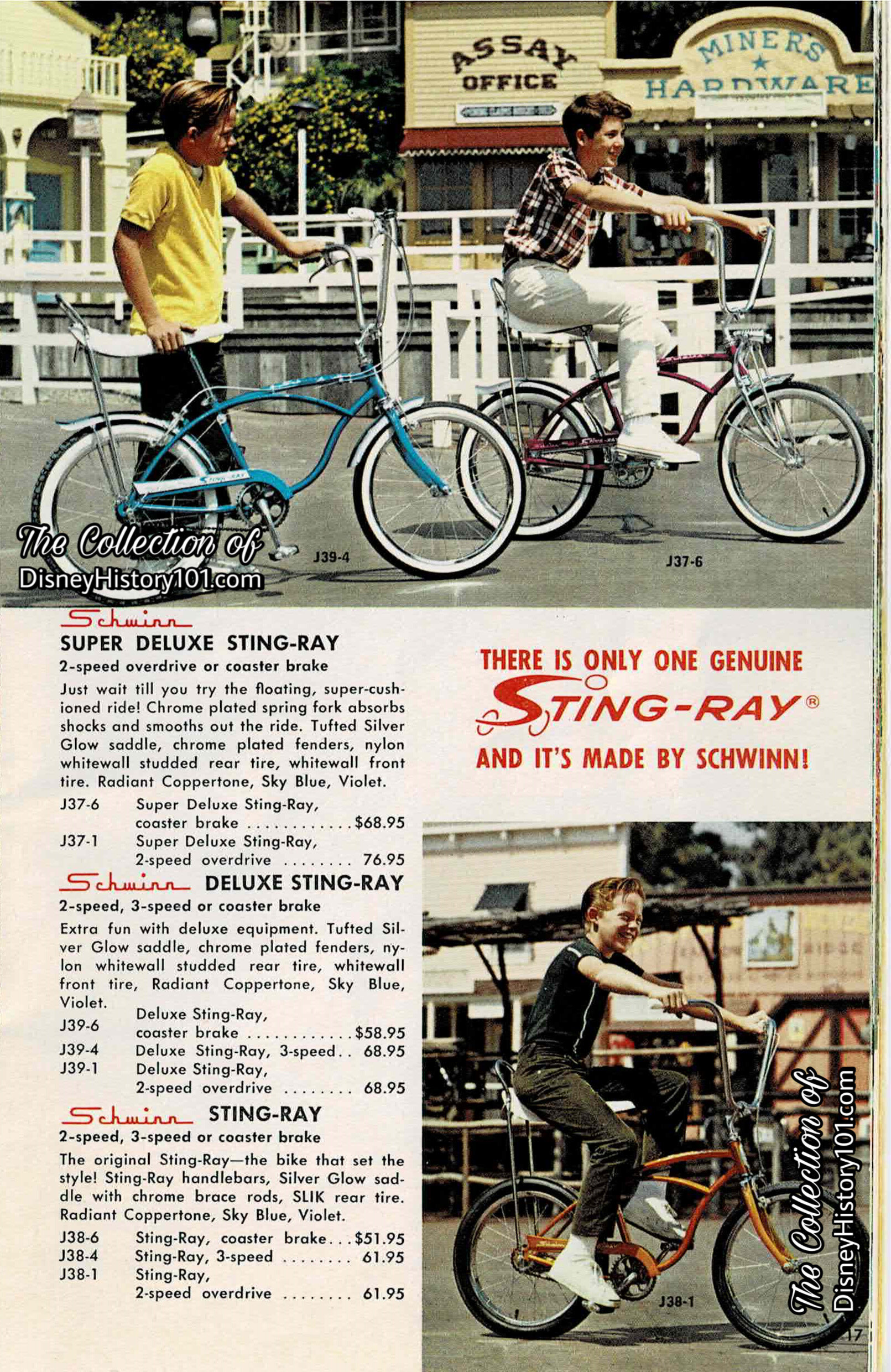
“Maintenance”
Since the beginning, the Four Keys of the DISNEYLAND Show (operating priorities in presenting the DISNEYLAND Show) have been present - Courtesy, Safety, Show, and Efficiency. Guided by these Four Keys, are Walt Disney Imagineers, who are always seeking out new magical opportunities to increase the efficiency, safety, and showquality of Disneyland adventures.
“55er” Jim Harman remembered “l used to fight gophers in Nature's Wonderland At that time, the sound speakers were hidden in false rocks and the gophers would fill the speakers in with earth. They sent me into combat with the critters… I remember how, during the course of a season, the ants would eat the real fur off of the birds and animals.” During rainy seasons, the animals were covered to protect their fur and feathers.
In the name of the overall Park Show Quality, many rehabilitations kept Rainbow Ridge, and all of Nature’s Wonderland looking like a true-life adventure. For instance, Bob Johnson (who began working as the Park’s taxidermist under Bud Washo around 1960) made “the rounds of his 230 animals in Frontierland,” according to Backstage Disneyland (Fall of 1965). The same article continues : “In other scenes Bob has added a domestic touch by creating three baby skunks and two baby owls and placing them next to their adopted parents. Bob is also good at improvising. The plastic claws on the black bear broke repeatedly on the bottom of the stream as the bear scooped for fish. Bob solved the problem by designing a set of rubber claws.” Bob even rehabilitated the most difficult to recover - “the two diving bears” which “bob up and down and turn from side to side. The skin must have enough slack to allow movement yet not look too shabby.”
Owning to the maintenance and rehabilitations, Disneyland (and the Mine Trains) have occasionally been utilized as a backdrop for many advertising campaigns made for television and publications (like magazines and newspapers). For instance, during September of 1962, Max Stewart, Larry Clemmons, and Art Crookshank (of the Walt Disney Studio) filmed and shot scenery from a Mine Train for Studio Production #3185. In their “minutes” they described their shoot this way : “We moved to the Mine Train Loading Dock. The Mine Train was held up (8) minutes. We loaded two Mine Trains, backed them up into the Rainbow Caverns and cued them non-stop through the loading dock.”
About two years later, during July of 1964 (and in the name of Show Quality, before it was so-named), Bob Matheison (of the Customer Relations Division) was studying an area near the Mine Train and coming up with “a recommendation as to whether… [Disneyland] should have musicians there on Friday and Saturday evenings, within budget.” About one year later, photographs for the “Schwinn Takes A Trip To Disneyland” catalogue (including this one pictured above, where the town of Rainbow Ridge used as a background for the new Schwinn Fastback Sting-Ray models) were both shot at Disneyland during the Disneyland Tencennial celebration of 1965.
By 1964, the character of the 11th hole of The Magic Kingdom Golf Course of the Disneyland Hotel Golf Centre was still themed after the Painted Desert.
From April 30 to May 25, 1973 the Mine Ride was closed for a 4-week rehabilitation.
From late 1974 through early 1975, Marc Davis and George McGinnis worked on several proposals for the addition of an earthquake sequence for the Mine Train Thru Nature’s Wonderland in which the locomotive would detach from the train and its cars of passengers would “run away”, passing molten lava, a disturbed owl and a panicked bear. But they never got around to developing this concept further.
At least one Mine Train was used to carry Karen and Richard Carpenter during the filming of several scenes for their “Mr. Postman” music video released in 1975.
But by 1977, it was time to say “goodbye” and bid “farewell” to the two acres surrounding Rainbow Ridge as we knew it. The town of Rainbow Ridge disappeared from the hills overlooking Frontierland some time in 1977, when construction began, of the soon-to-be-iconic Big Thunder Mountain - ‘the wildest ride in the wilderness!’ Most of the buildings were temporarily moved to the Backstage, in order to be redeveloped for their relocation to Thunder Ridge. Some (like the Panhandle Hotel and the Big Thunder Epitaph) were present in 1956, and went on to exist for several decades.
Maintenance salvage and tree boxing began around March of 1977, to “determine those elements of scenery and animation which can be saved from Nature’s Wonderland and put to future use.” Any critters that could be salvaged needed to be cleared out by May, when major demolition was scheduled to begin. [Disneyland LINE, February 24, 1977] Some simple figures and static figures (like coyotes, desert deer and marmots) were preserved, or repurposed, while a few that could not be moved, were either paved over or left in the river.
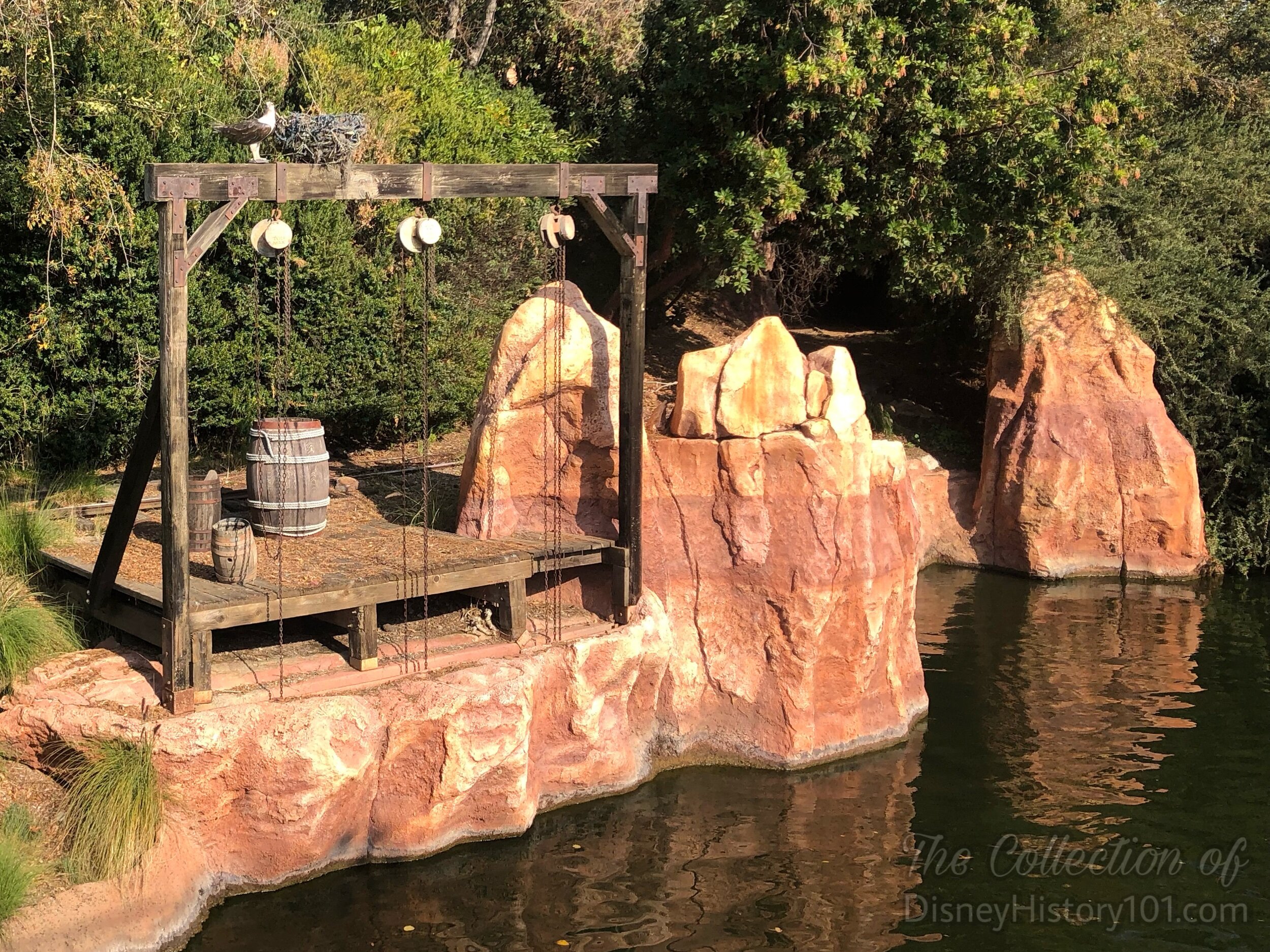
Some descendants of Nature’s Wonderland still populate parts of Frontierland. For instance, “the legend of lobo” lives on near Big Thunder Mountain. Last (but not least), thanks to the c.1984 Imagineered renderings of Gene Johnson, at least one old Mine Train (the victim of a land slide) sat abandoned on tracks along the Rivers of America, where it became home to quite a few “playful marmots” from about 1985 to 2010. A 1984 report revealed that the Mine Ride Cars weighed 2,200 lbs. while the Mine Ride power unit weighed 9,600 lbs.
You may recall once purchasing a print of Gene’s concept through The Disney Gallery.
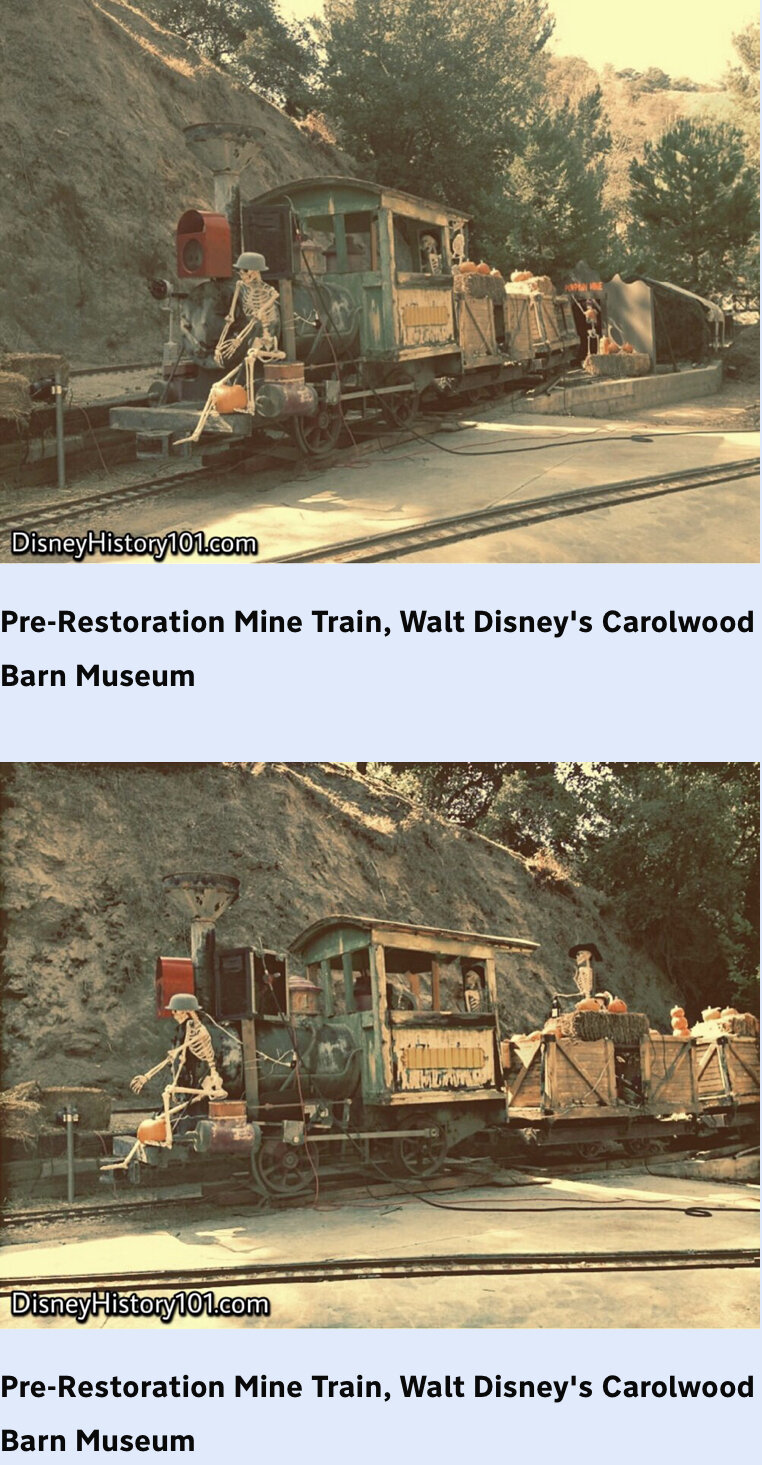
We’ve heard of some strange happenings…stories of an abandoned old mine train vanishing from tracks along the Rivers of America (some time in 2010), and reappearing some 35 miles away in Griffith Park, California (during 2015)!
After some negotiations and an agreement between the Walt Disney Company and the Carolwood Foundation and Carolwood Pacific Historical Society (which is known for its preservative nature toward train-related Walt Disney artifacts), the Mine Train locomotive, tender, and gondolas disappeared yet again (but this time for careful rehabilitation). In May of 2019, former Orange County Register contributor Mark Eades wrote a wonderful sneak preview of the Mine Train locomotive, tender, and gondola, as well as an update on the “Disneyland Mine Train Restoration Under Way” [which can be read by visiting the LINK HERE].
Finally (in 2019), one of the gondolas was unveiled through a limited engagement held at the MUZEO Museum and Cultural Center in Anaheim (another fine institution which perseveres some Disneyland history in relation to the story of Orange County)!
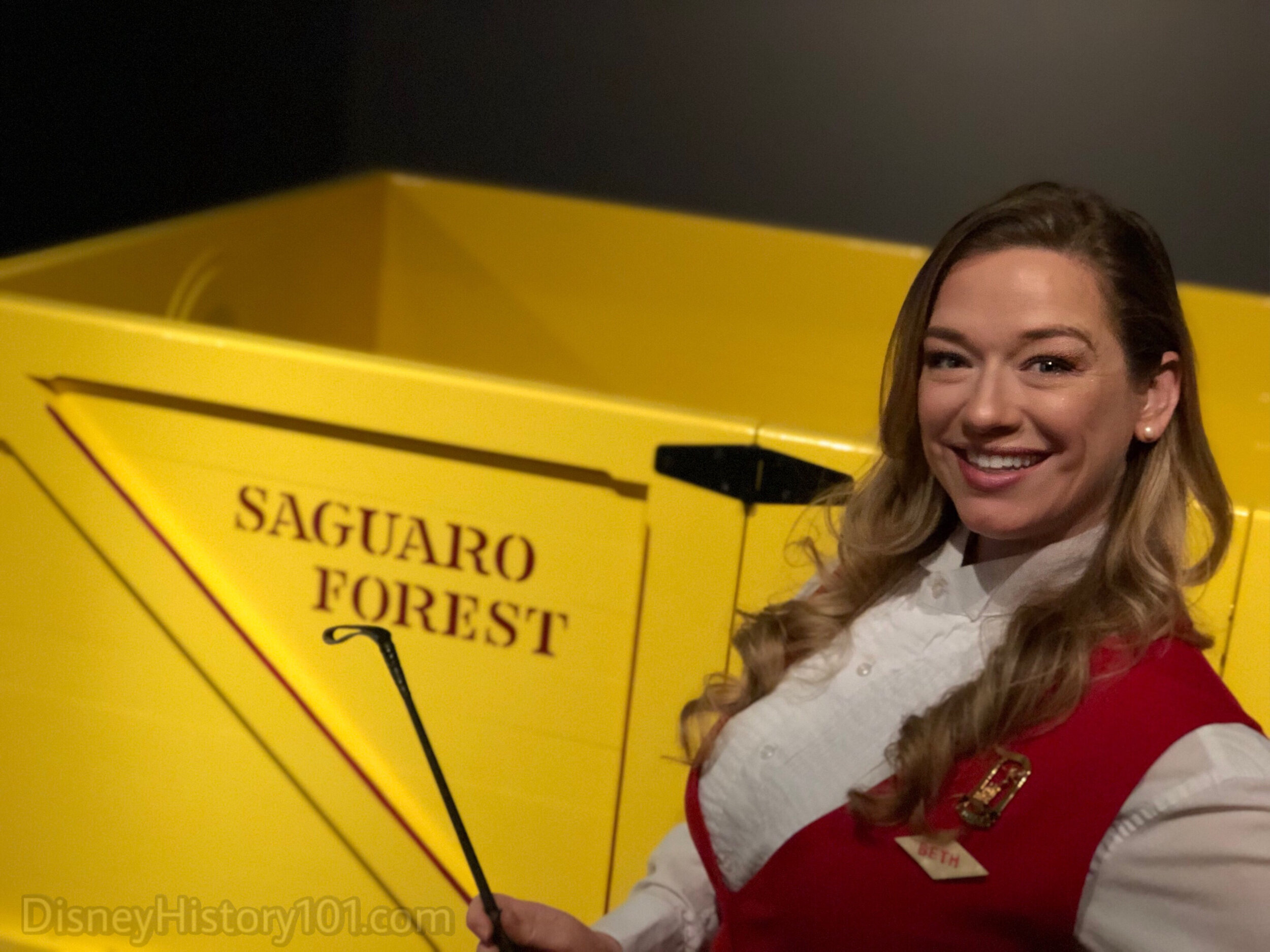

A designation has been applied to one of the two cars being restored - SAGUARO FOREST! What will the other cars designation be?
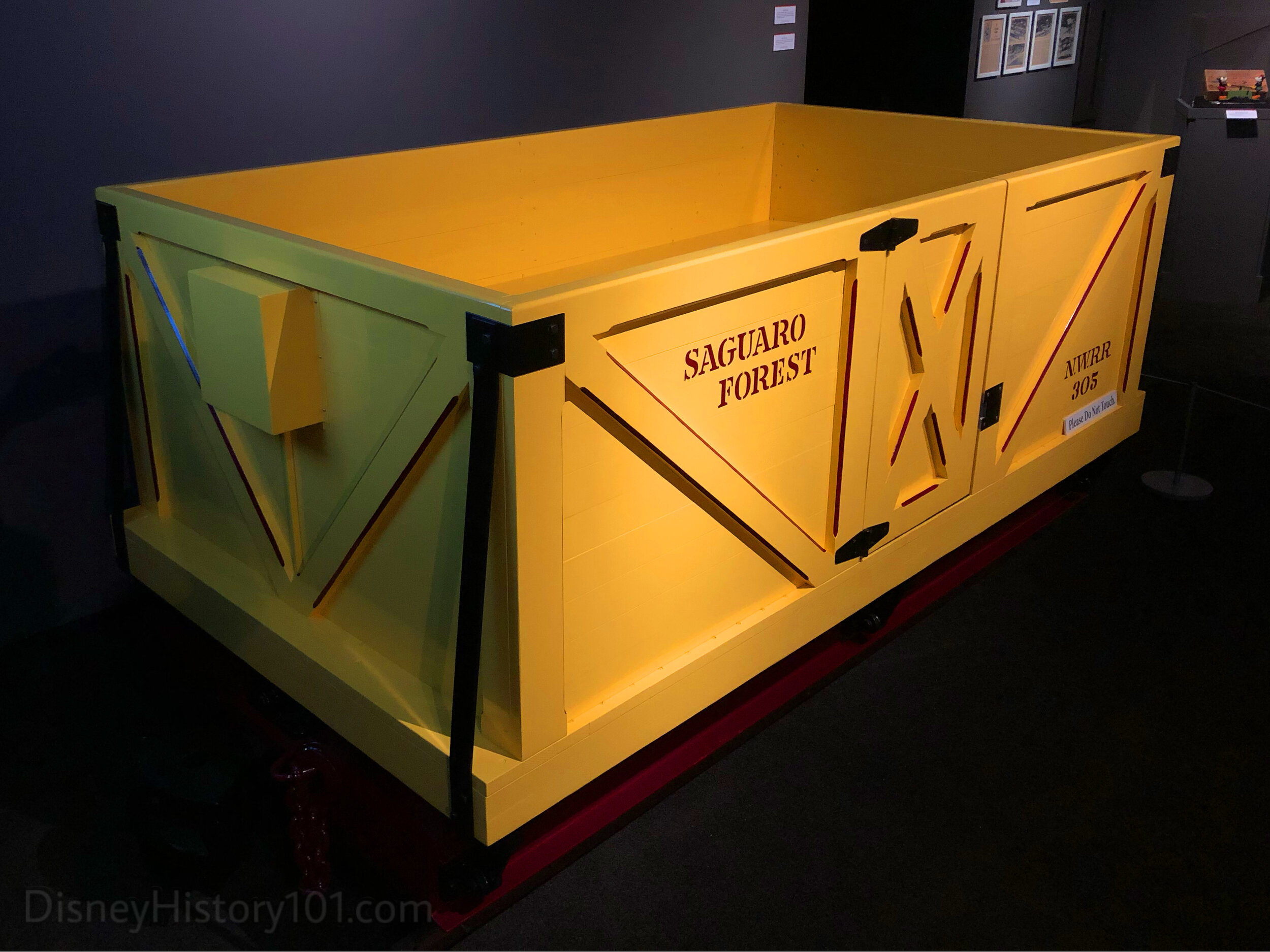
We’re looking at one of the “Mine Train Through Natures Wonderland” gondolas restored by TLJ Construction, Incorporated in Burbank, California. This much anticipated preview comes courtesy of The MUZEO museum (in Anaheim), and the Carolwood Foundation. According to curators : “this mine car was one of seven passenger cars coupled to Locomotive #1 on the Nature’s Wonderland Railroad.”
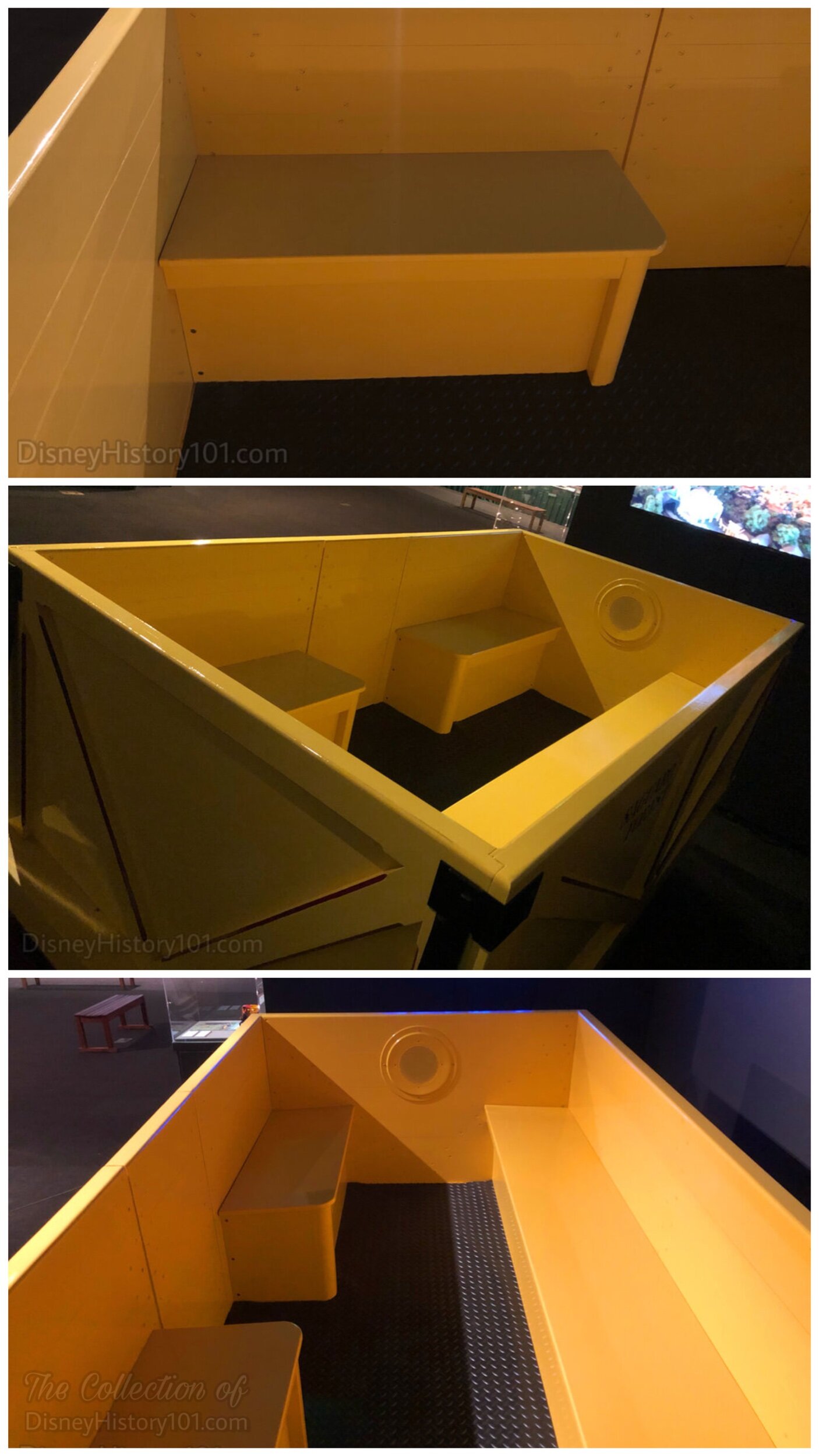
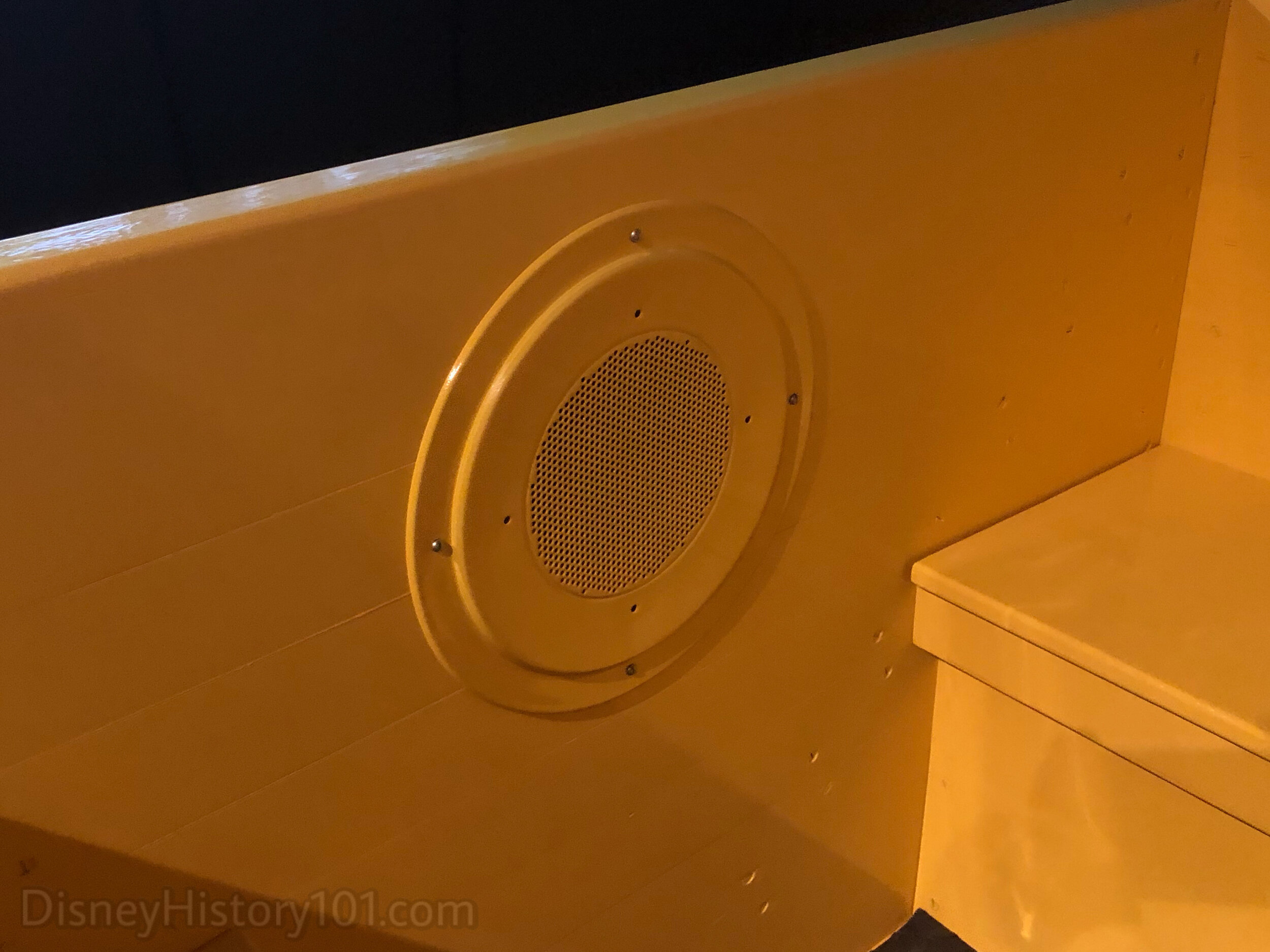
Will this speaker eventually broadcast a version of the pre-recorded spiel? Only time will tell.
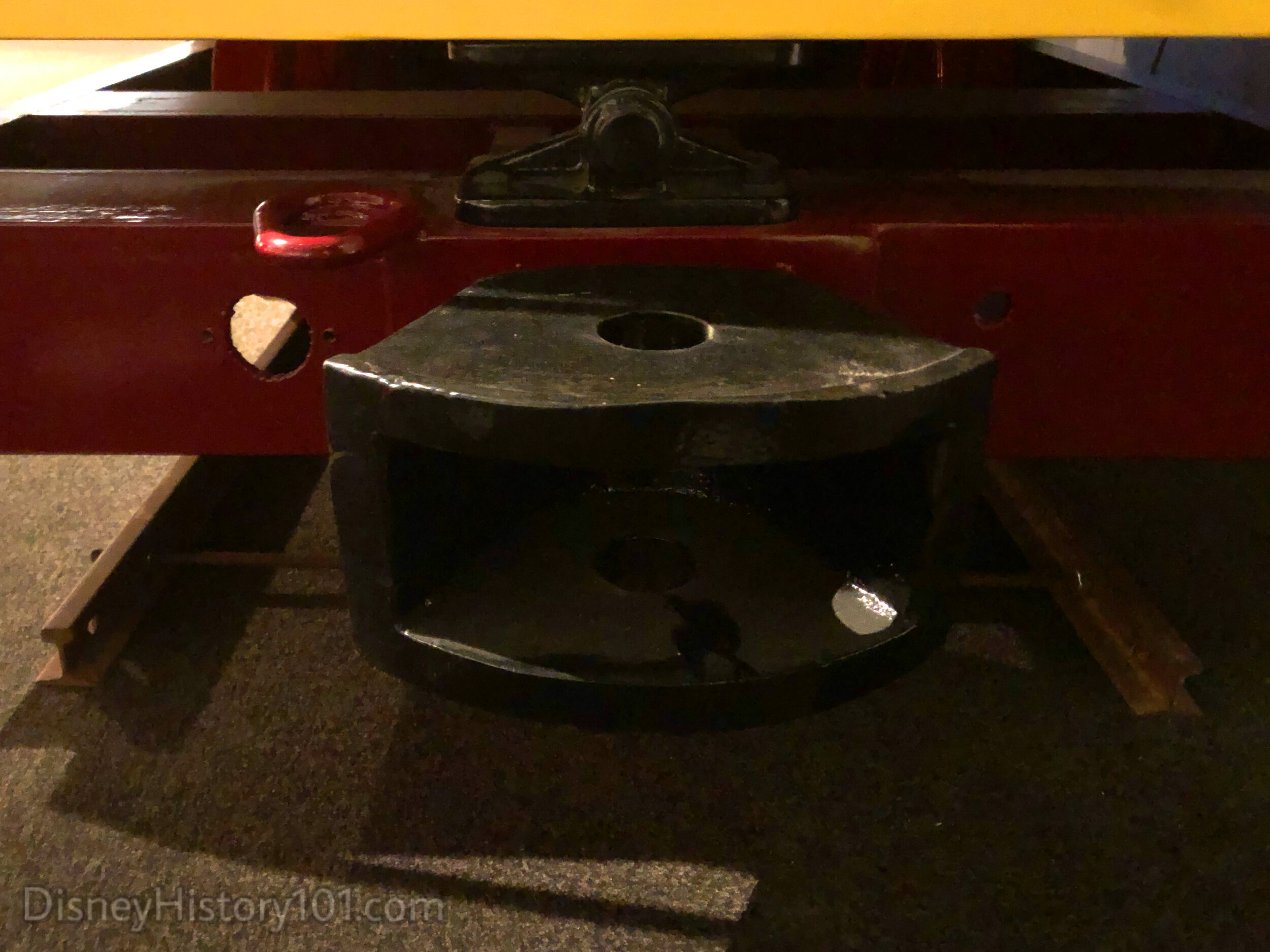
Many of the original metallic parts (like this coupler), were the first parts to be cleaned up and restored to their former glory.
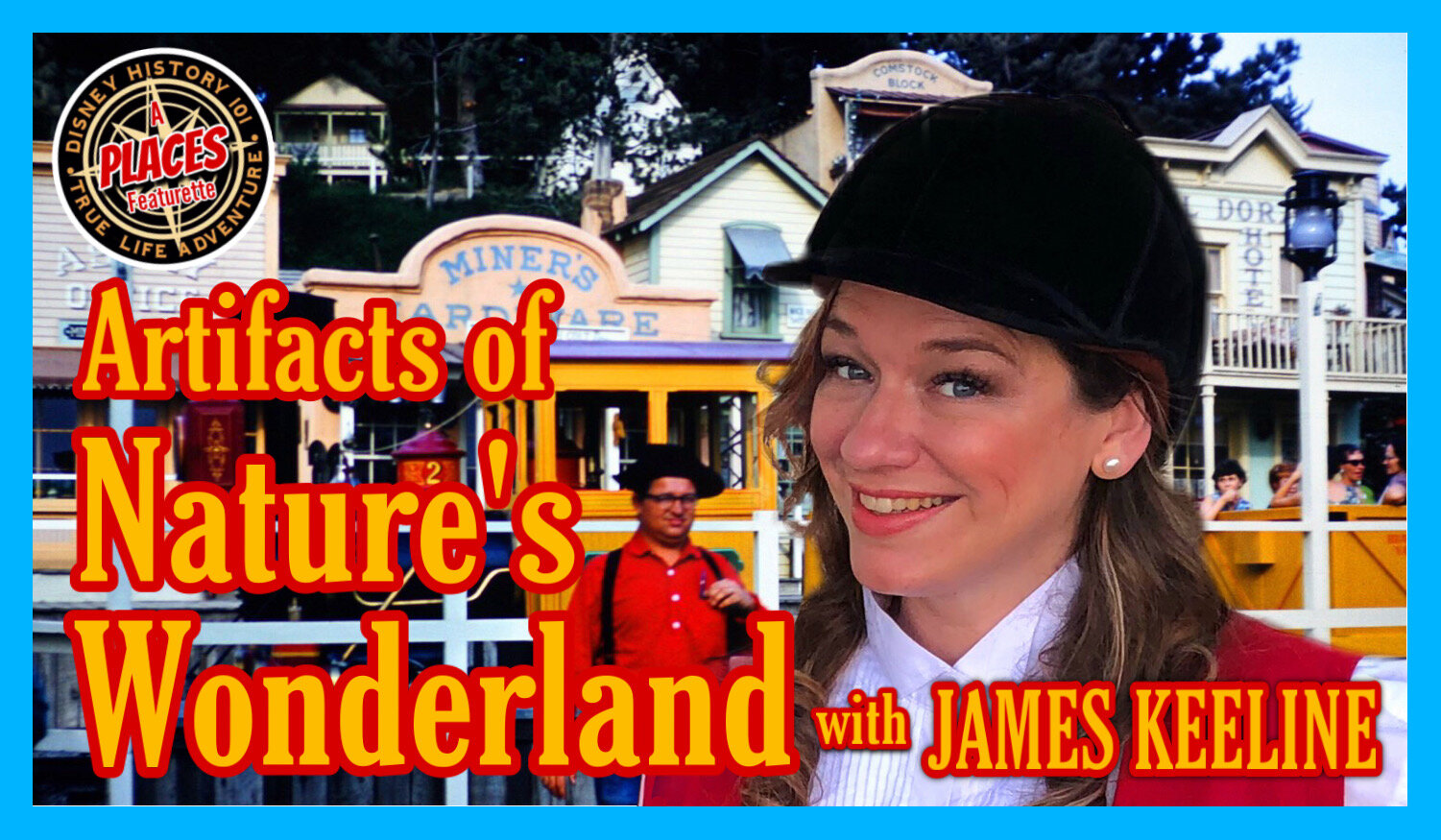
Here, Mine Train enthusiast and historian James Keeline shares a few artifacts from the mining town of Rainbow Ridge, and “a tale of two critters” that once inhabited the desert-scape of the Painted Desert!
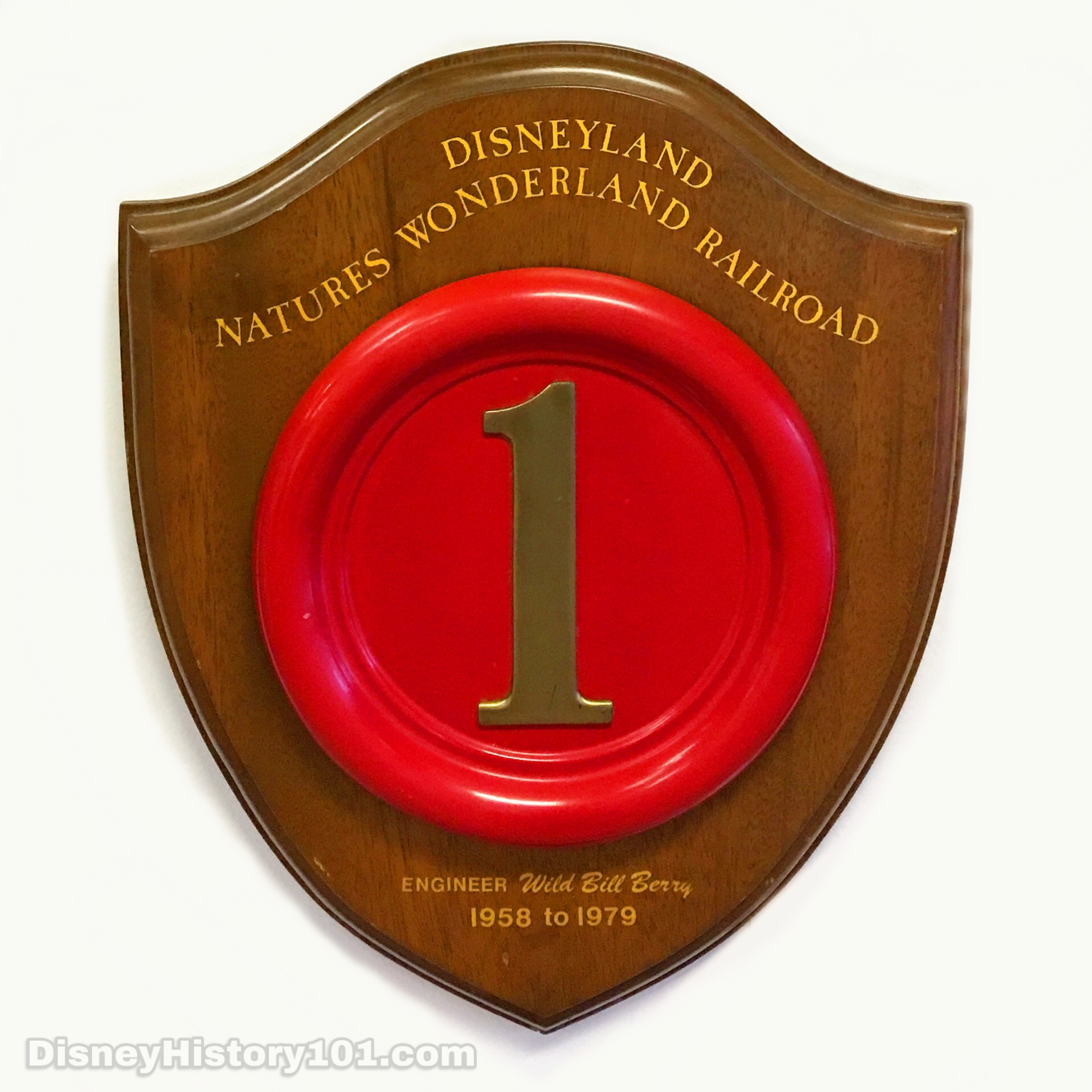
Upon retirement, replica engine plates were made into plaques. These plaques were given to members of the Order of the Red Handkerchief. This particular plaque was bestowed upon “Wild Bill” Berry, an engineer who operated engines from 1958, right up to the attraction’s close in 1979!
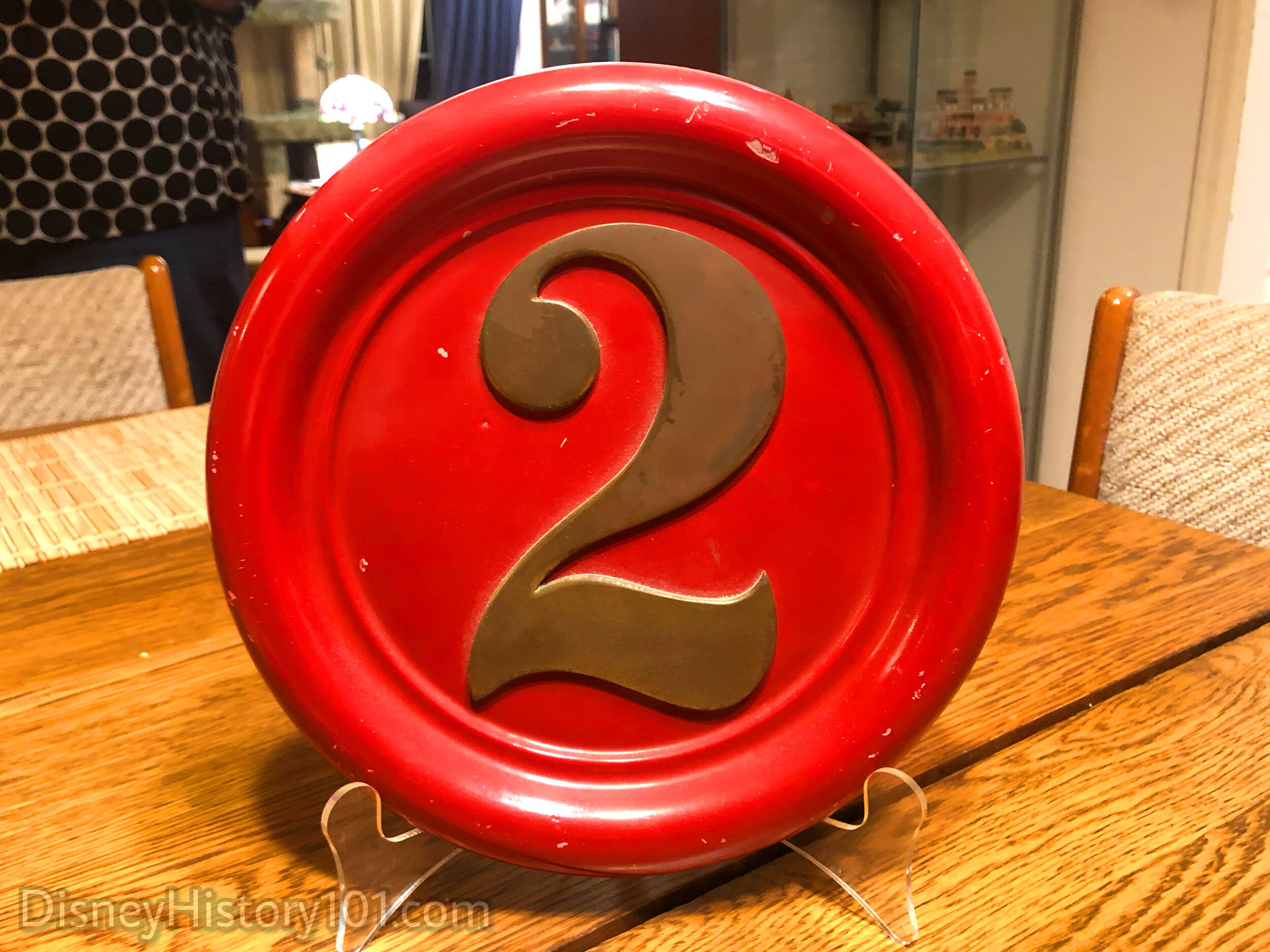
This is actually one of four Number Plates, from the Rainbow Mining & Exploration Company era (of green-colored mine trains). The trains of that era were 3, 4, and 5, and this Number Plate is actually No.5 repurposed into Plate No.2.
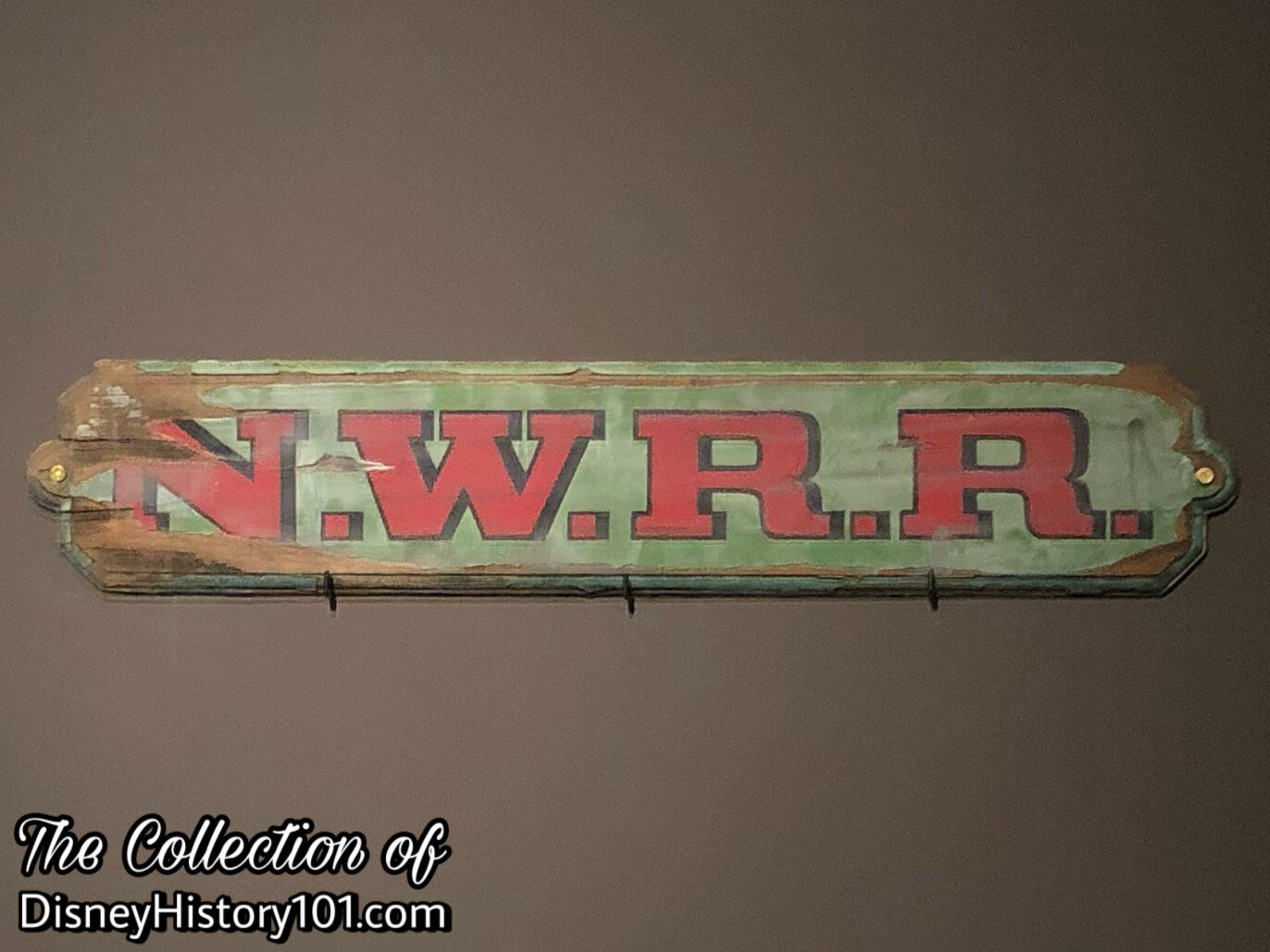
(Property of the Walt Disney Archives ; On loan from Walt Disney’s Carolwood Barn)
According to curators : “The Nature’s Wonderland Railroad sign is originally from Locomotive #1 of the Mine Train Through Nature’s Wonderland, which ceased operations in 1977 and was later replaced by Big Thunder Mountain Railroad.”
MULE PACK (RAINBOW RIDGE PACK MULES)
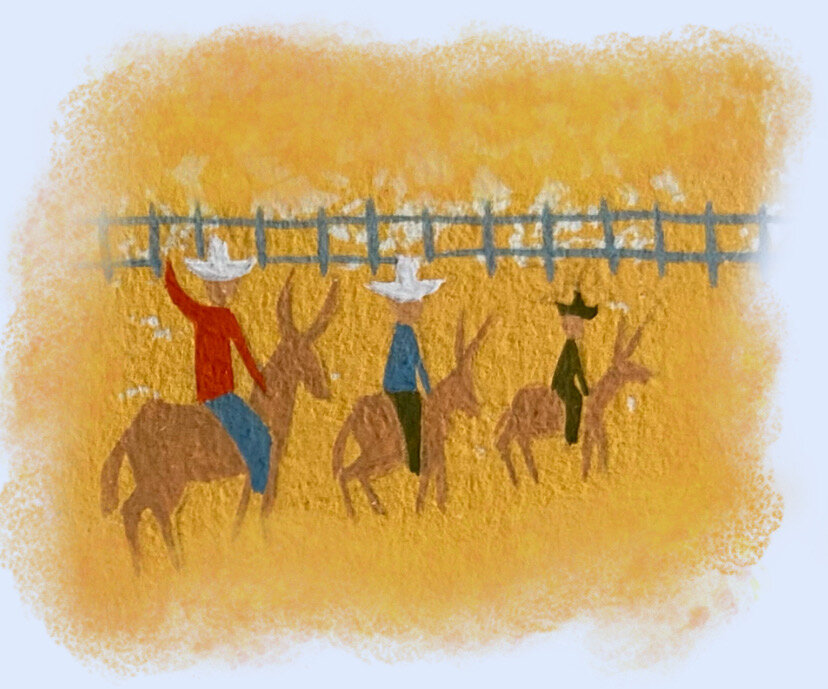

At Disneyland there is a "story behind the story" of every attraction, every attraction is a living experience for the guest. Disneyland ride-through attractions or adventures have officially been defined as an “individual show, ride, or exhibit designed to produce an entertaining Guest experience. Disney attractions stir the imagination, enliven the senses, and provide the participants with positive, innovative entertainment, which is the essence of the DISNEYLAND Show.” It is important to review the story of the attraction, tell the story, explain it, and create interest. This is the story of the Mule Pack.
Equine regularly factored into the plot of Walt Disney Productions (like “Don Donald”, released 1936, which co-starred Jenny the Burro), and equine have always been part of Walt’s vision for a Park. An early form of (what would come go be known as) the “Disneyland Prospectus” [prepared in 1953 for Disneyland Inc. by WED Enterprises], mentions a Mule Pack Ride - “Take a Mule Pack Ride with an old prospector for a guide through the colorful mother-lode country of the pioneer days.” The contemporaneous “Proposed Diagramatic Layout of Disneyland” (Marvin A. Davis’ plot plan, produced for WED Enterprises, by September 12, 1953) detailed a “Pack Mule Ride” as well as its route through this section of “Frontier Land.” It was also written that “the Mail-Order Catalogue will picture everything for sale in the Emporium or at any place in Disneyland. If you want a real pony and cart or a miniature donkey thirty inches high you’ll find it in the catalogue.” Clearly, the development of Disneyland necessitated Owen and Dollie living on the Walt Disney Studio Lot for the duration of their development.
One of the foremost aspects of future Disneyland attraction development that Owen supervised was fabrication of equine tack during 1954. Diane (eldest daughter of Walt Disney) once recollected, “Dad’s first grandchild, Christopher , was born in December of 1954. Disneyland was under construction at the time, and Owen and Dollie Pope were hired to acquire and train the horses and mules that the park would need to pull the horse cars and stage coaches down Main Street. To be close to the horses, the Popes lived in a trailer on the Studio’s back lot and then at Disneyland. Dad would often visit them and the horses. Owen was a skilled saddle maker and made this miniature saddle as a gift for Dad’s first grandchild. My husband Ron was in the army and stationed at Fort Ord, and we were living in Pacific Grove, California. When Mom and Dad flew up to see their first grandson, Dad brought this little saddle with him.”
Owen and Dollie also oversaw the breeding and care of these Sardinian Donkeys, which were intended for “Frontier Land, which is Disney’s favorite section of the fair,” according to Loius Berg (Reporter for “This Week Magazine”)! In fact, they looked after the first Disneyland Cast Member. The “lovable little mule, Picolino, was the first of his breed to be ‘hired’ to work at Disneyland.” On that day, Walt Disney personally commissioned Herb Ryman to paint a portrait of Picolino (the first Disneyland Cast Member) to celebrate the occasion, and this Herb did, while standing with brush in hand before the Studio coral, according to “A Brush with Walt Disney” edited by Bruce Gordon and David Mumford, page 1963.
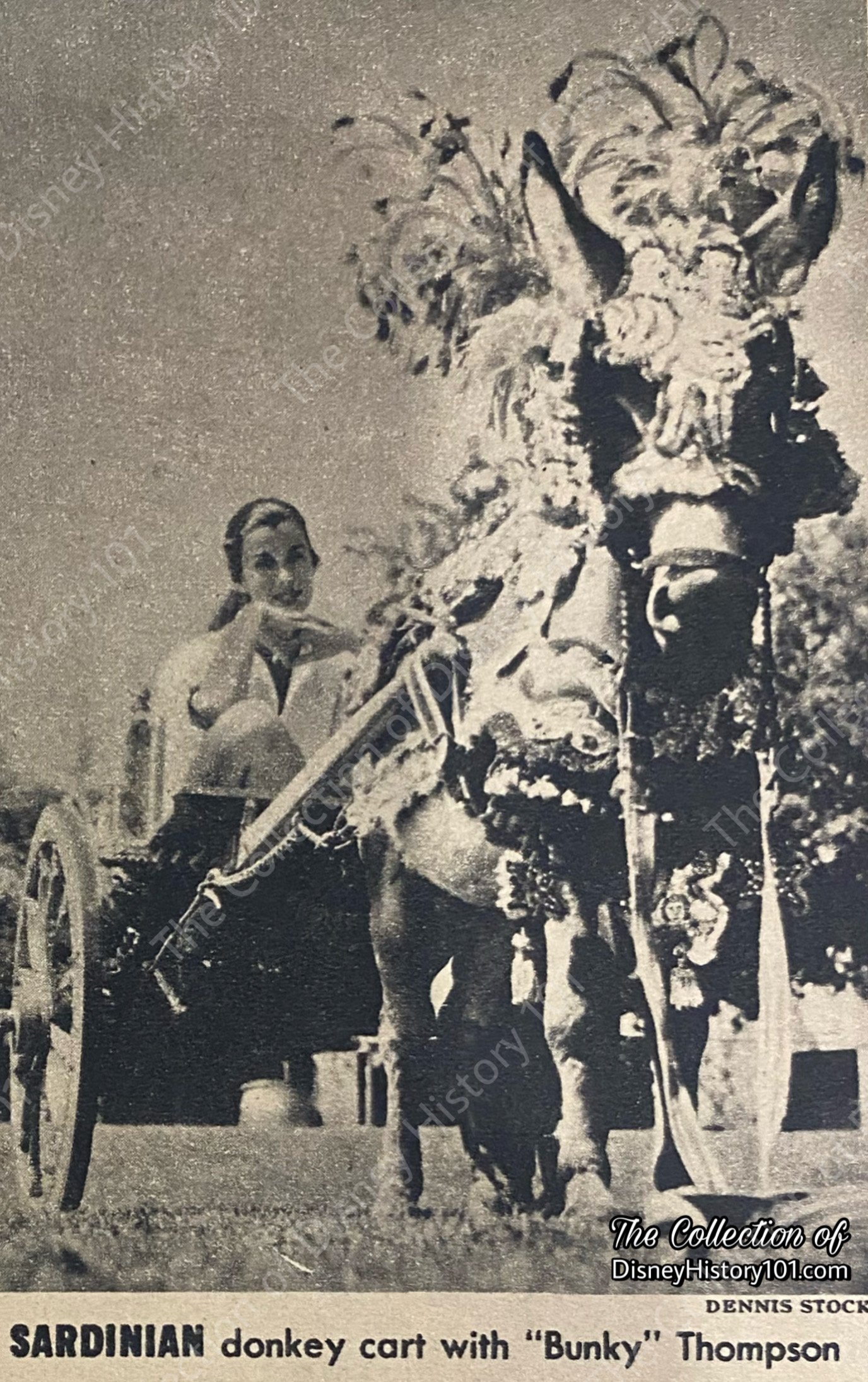
Many years prior, Walt had spent a number of his formative years on a farm run by his father Elias. So, it was only natural that Walt enjoyed the animals around the Studio. A testament to this was the account of Louis Berg, who had the privilege to tour the Walt Disney Studio “stud farm” late in 1954. He soon divulged : “I visited the stud farm where the midget horses, ponies, and Sardinian donkeys that will draw the wagons, carts and surreys are being nursed. And it’s a sight in this world to watch the tiny foals nuzzling up to mothers themselves no bigger than a normal foal. Disney knows every colt and every pony by name, and can tell you the characteristics of each of the several hundred animals : one likes to chew on cigarettes, another is a brat. ‘Get away, General,’ he said to a young colt that was biting his trouser leg affectionately.” Herb Ryman [in “Work With Walt” by Don Peri] collaborated Louis Berg’s observations, recalling how Walt “loved the the little animals - the little horses, ponies, and mules.” And Walt wasn’t the only one who loved the animals at the Studio. In his interview, Louis Berg continued : “Incidentally the pony corral is the favorite of Disney employees and their children. Most constant visitor is ‘Bunky’ Thompson, receptionist, who spends lunch hours feeding the animals.”
“55er” Day Sechler recalled: “At Disneyland, … Walt [sic] came to the Pony Farm a lot to watch us break horses. He was always concerned if he could do anything for you.”
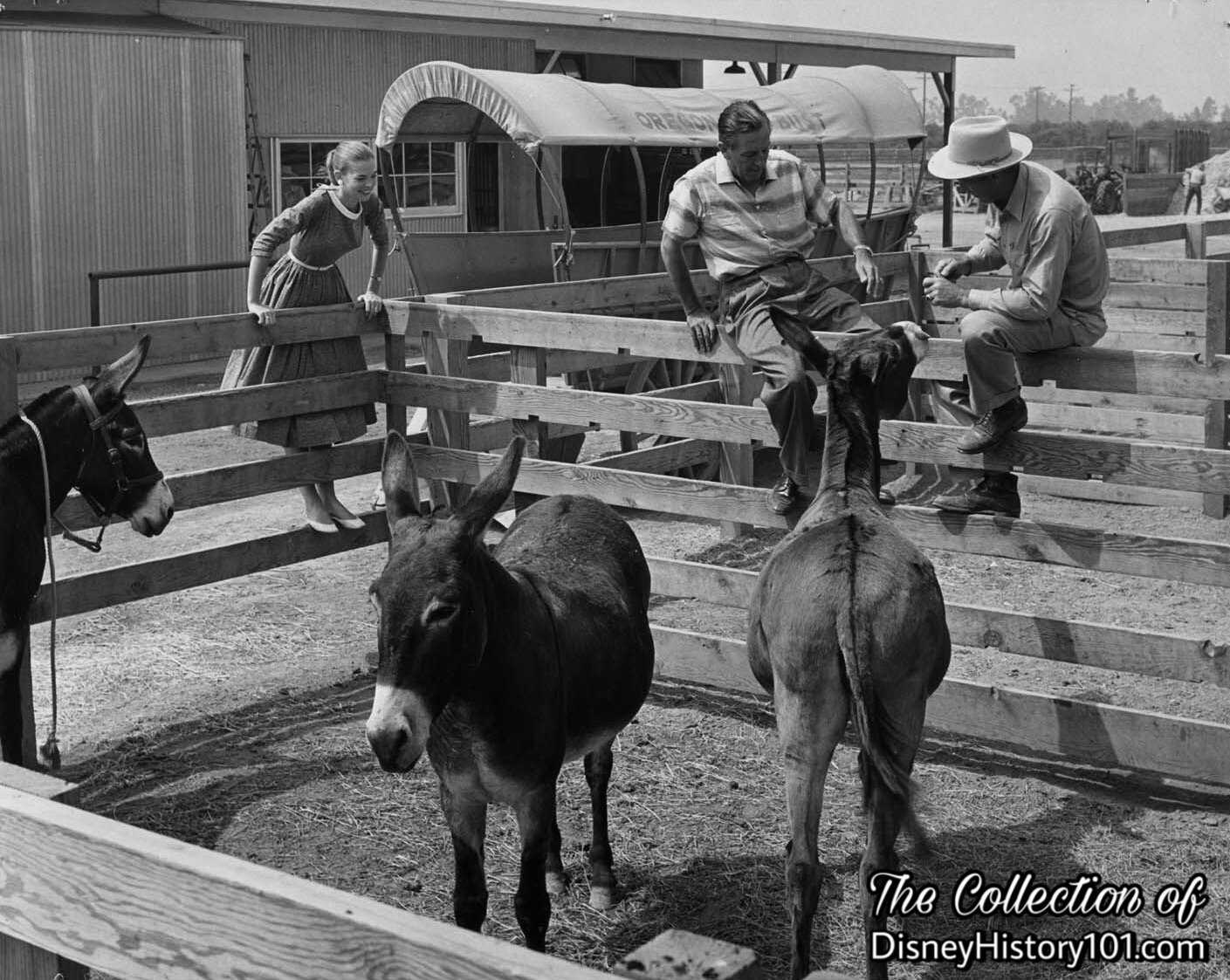
Soon one authorized “Disneyland Information & Nomenclature List” (prepared by Bill Cottrell of Disneyland Inc., by May 25, 1955) divulged the details of the “Mule Pack Ride” to Disneyland, Inc. employees in the following way : “A pack ride into the motherlode country in the Old West.” Further, “2 packs” were detailed, consisting of “1 lead horse and 9 mules in each pack.”
While most employees of Disneyland attended an orientation program, during this era, there were many Pony Farm employees who did not attend these sessions. Van Arsdale France remembered: “I think I managed to schedule almost everyone through orientation, with one exception. My only failure was with the people who were to operate the horse drawn vehicles. This operation was controlled by a crusty man named Owen Pope, whose headquarters were in what is still called ‘The Pony Farm.’ When I cornered him, he explained by saying, ‘Van, you're dealing with people people. We're horse people out here.’ He finally sent me one or two of his men. But, he was. doing his own training program.”
Before the Park opened, the Mules, Burros, and all equine were prepared for the noises that they would hear once On Stage in Frontierland (and other parts of Disneyland). Van Arsdale France once wrote: “He [that is, Owen Pope] was worried about the horses ‘spooking’ with all the sights and sounds of Disneyland. So, a recording of sounds from arcades and shooting galleries, and yelling kids made up. This was used as an audio aid for horse training. Since the horses were not directly on the payroll, they had to be carried as assets. All were given names. They all received names of people in accounting. Lucy Cotton, for example had a mule on the records named, ‘Lucy Mule.’” In so doing, Mule Wranglers who assisted Owen knew each equine “in their strings” including the new mules born at Disneyland.
One insert in area newspapers described how “Some of the more stubborn animals slid around the training area on their haunches two or three times before accepting the idea the older, lead horse was trying to get across. Trainers say all horse drawn equipment, from Frontierland stages to Fantasyland's Sardinian carts, will show the Disney perfection on opening day, July 18.”
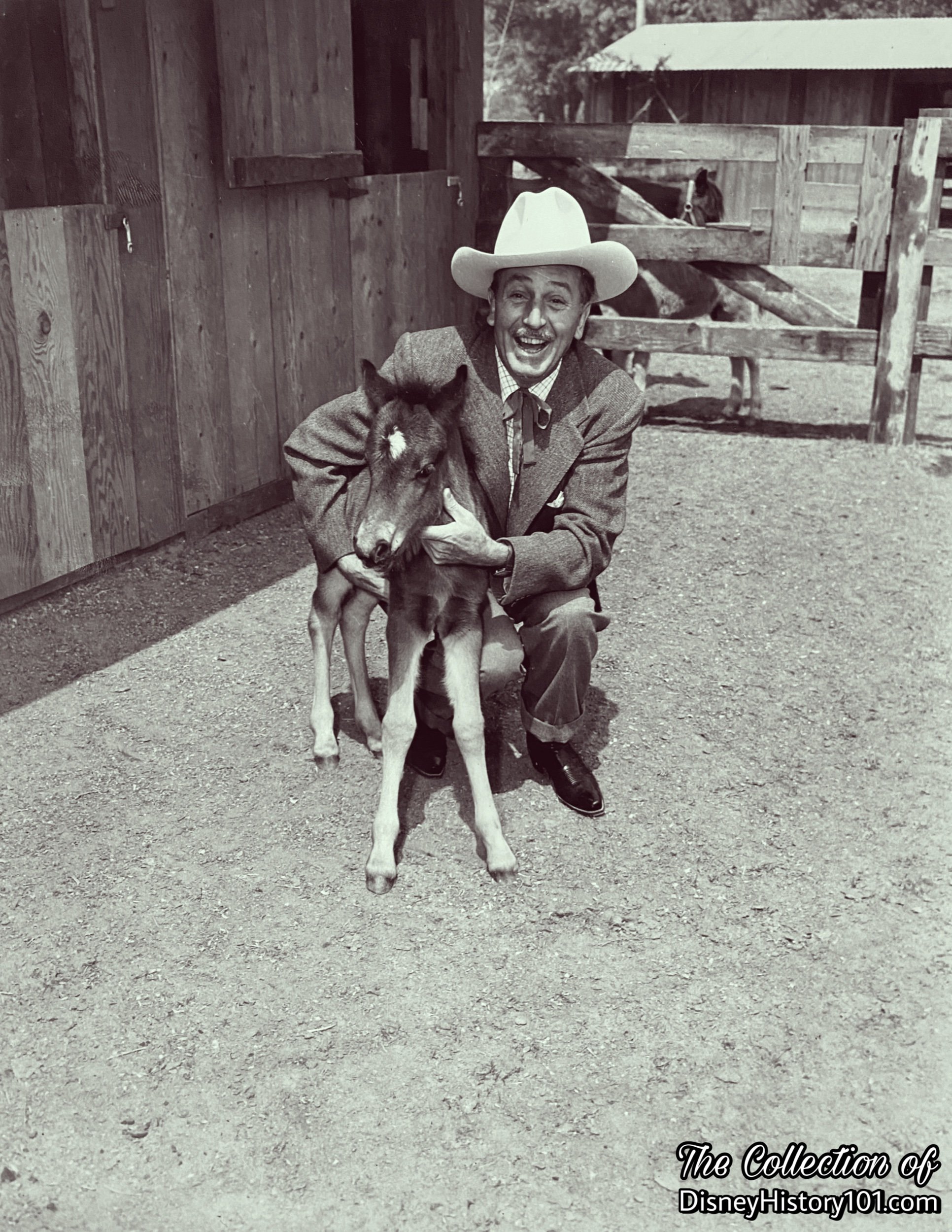
New additions to the “Pony Farm” stock stem back to Disneyland’s opening year, when Atom the Burro (“Disneyland’s first citizen…born on the Magic Kingdom’s Pony Farm”), was introduced into the world before Disneyland opened. You may recall this image printed on the cover of special newspaper sections published Friday, July 15, 1955.
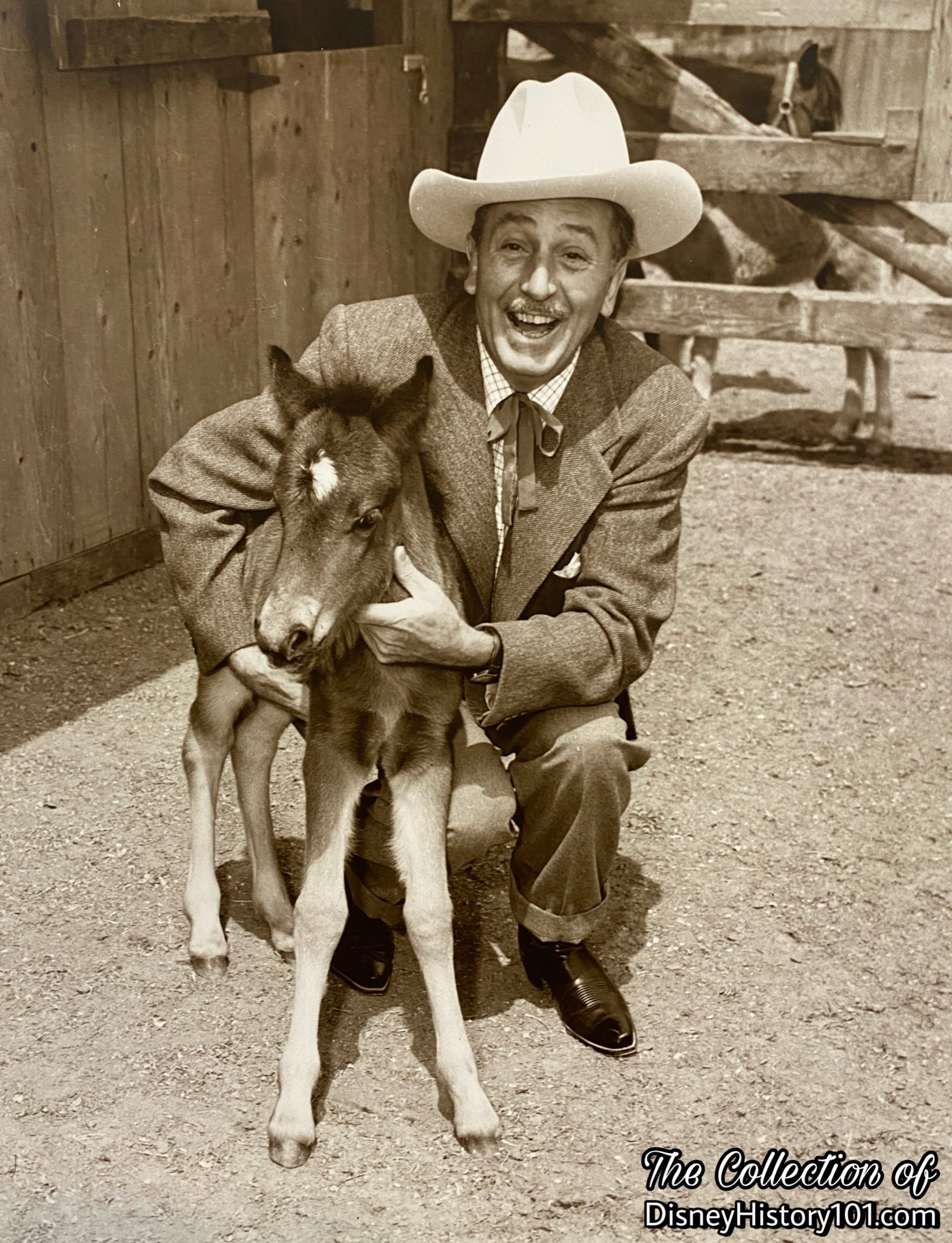
Walt loved his Disneyland equine. For instance John Catone recalled seeing Walt “riding around the Park on a white horse.” Atom (above) is seen on the cover of the “Premier Souvenir Edition” of the Independent Press Telegram, published Friday, July 15, 1955 and on the inside cover of Disneyland Holiday (Spring of 1957) where he is depicted with the caption: “Walt Disney and a friend.”
Some mules were named after Disneylanders, like Lucy Mule (named after Lucy Cottom), and Burro Male Jim 2 (named after Jim Quigley). Occasionally, animals (including at least two mules) were sold - even before Disneyland opened. Hand-written notes made during the 1958-59 appraisal of Disneyland preserve this information.
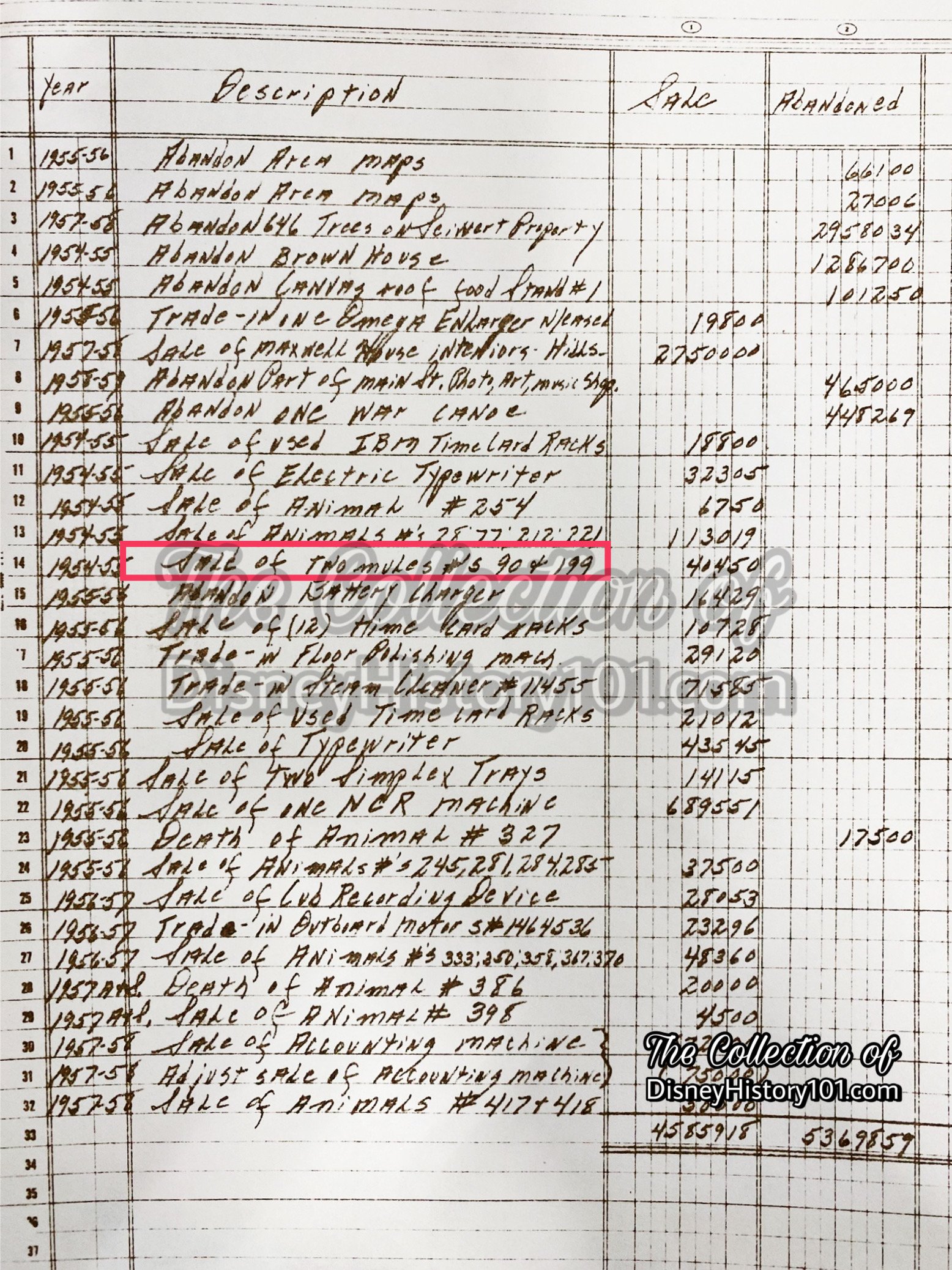
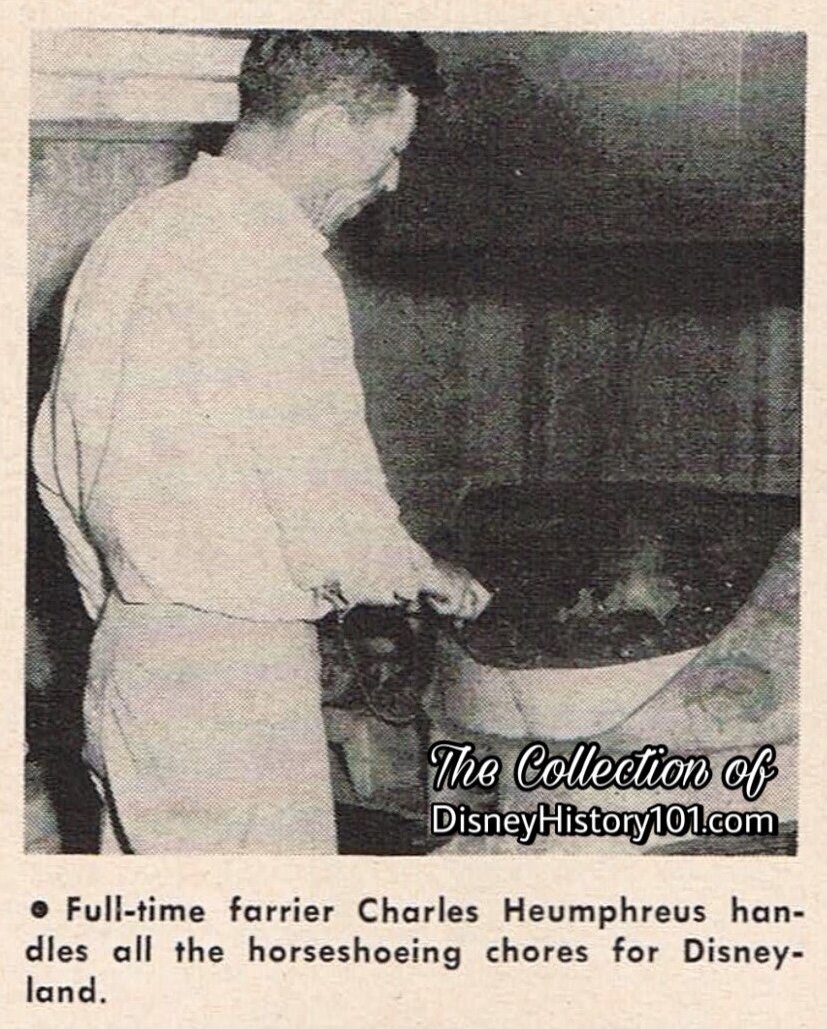
While the horseshoes of the Belgians, Clydesdales, Percheron, and Shire-Percheron cross-breeds were made of rubber (to generate the “clip-clop” sound on Main Street), the horseshoes of the Frontierland equine (mules, Sardinian donkeys, midget horses and ponies) which travelled through unpaved areas were made of iron metal, the old fashioned way. The old Mule Shoes were once stored in a barn at the Pony Ranch. But many years later (and long after most of the Mule Trains had departed from Disneyland), the old shoes were relocated and piled high under trees (and behind a fence) near Big Thunder Ranch.
Some equipment was purchased, like 16 saddles which were specially rigged with a 14-inch seat, purchased for $1,248, by October of 1959.
By July 1, 1954, George Whitney of Disneyland, Inc. directed Amusements, with Ron Miller overseeing analysis, philosophy, capacities, planning, operator training, and amusement procurement.

At last, the Press Preview Day arrived, with the “Pack Mules - two packs - one lead horse and nine mules in each pack,” escorting guests through the wild country of Frontierland! The Mule Pack would go on to hold a special place in Disneyland history, as 1 of 22 initial major attractions at Disneyland! “55er” Day Sechler recalled, “Where Fritos now stands was a loadin' dock for burros, we didn't have mules then. A burro belongs to the ass family." Earl Anderson recalled “On opening day, John Yarber and I got a call that the gate had fallen off the Mule Pack Ride, and that we were to go and fix it. We had not the slightest idea where the Mule Pack was.”
“Disneyland's Painted Desert was a playground for the James Unger family recently when they took one of the first pack mule trains a cross this miniature desert waste. Cactus and sagebrush was moved in and the area given its realistic appearance by Disney craftsmen and artisans. Led by a Disneyland trainer, the riders are Mrs. James Unger and sons, Melvin, 9; Albert, 12, and Richard, 2, riding with his father, James W. Unger.”
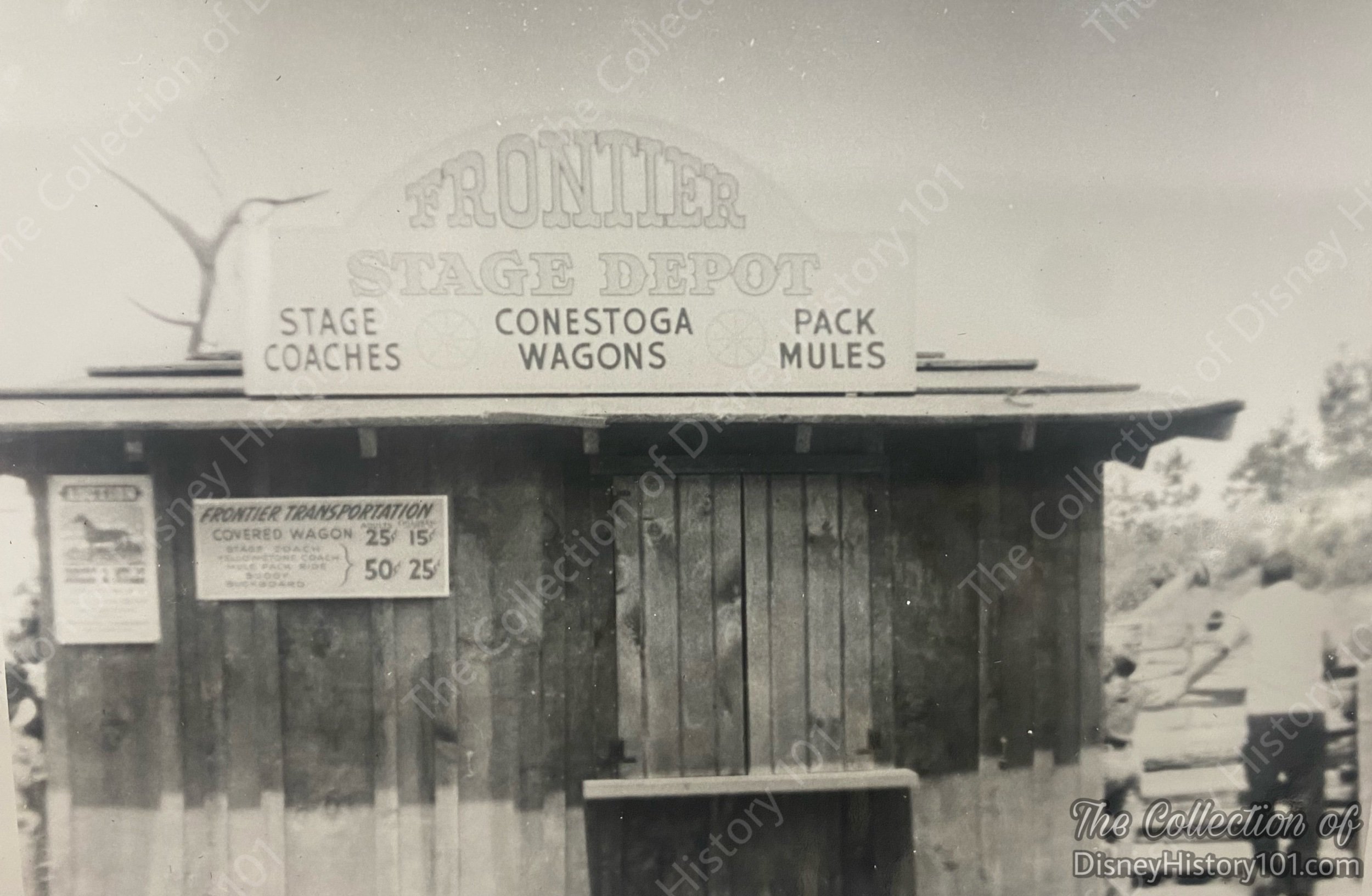
Many Hosts started out working the mule attraction, and assisting young guests onto the saddles and into the stirrups. For example, after some encouragement from Eugene Lemmon (of Park Management and Operations), the legendary Ron Dominguez even spent part of his first year with Disneyland, working with the Mule Pack (among other equestrian-based adventures). The adventure has been described as “unpredictable, certainly never the same ride twice.” Charley Brock recalled: “In May of 1956, I went to work on the Mule Pack Trip. I'd work the mules some and the horses some. A mule will only work so much and then he'll quit. A horse will work until he drops. Burros are pretty stubborn. I'd sure get mad at the mules sometimes out in the Park, but I'd save the swearin' at them fill I got 'em back in the barn. I'd call it 'MULE LANGUAGE!”
The attraction was very popular. Soon (within 1954-55), a Conestoga Wagon and Mule Pack model kit (potentially Walt Disney Productions licensed merchandise) was also suggested by the Strombeck-Becker Mfg. Co.


The Mule Pack soon went down for a major rehabilitation. Several years later (during 1961), Eleanor Heldt (Magic Kingdom Club Administrator) commented that “During a major rehabilitation, it is sometimes necessary to close an attraction for several weeks. This of course, is when the smallest details are checked, replaced, or repaired as required for the maximum safety, convenience, and comfort of our guests.” Beginning on June 26th, 1956, several new attractions (and enhancements) proved the truth of Walt Disney’s promise that Disneyland would continue to grow! As the mules were included among several exciting attractions debuting during 1956, that increased ride capacity, one day in August saw a peak total of “197,547 individual rides” enjoyed by Guests (according to a letter from Walt to Ward Kimball, dated January 23, 1957).
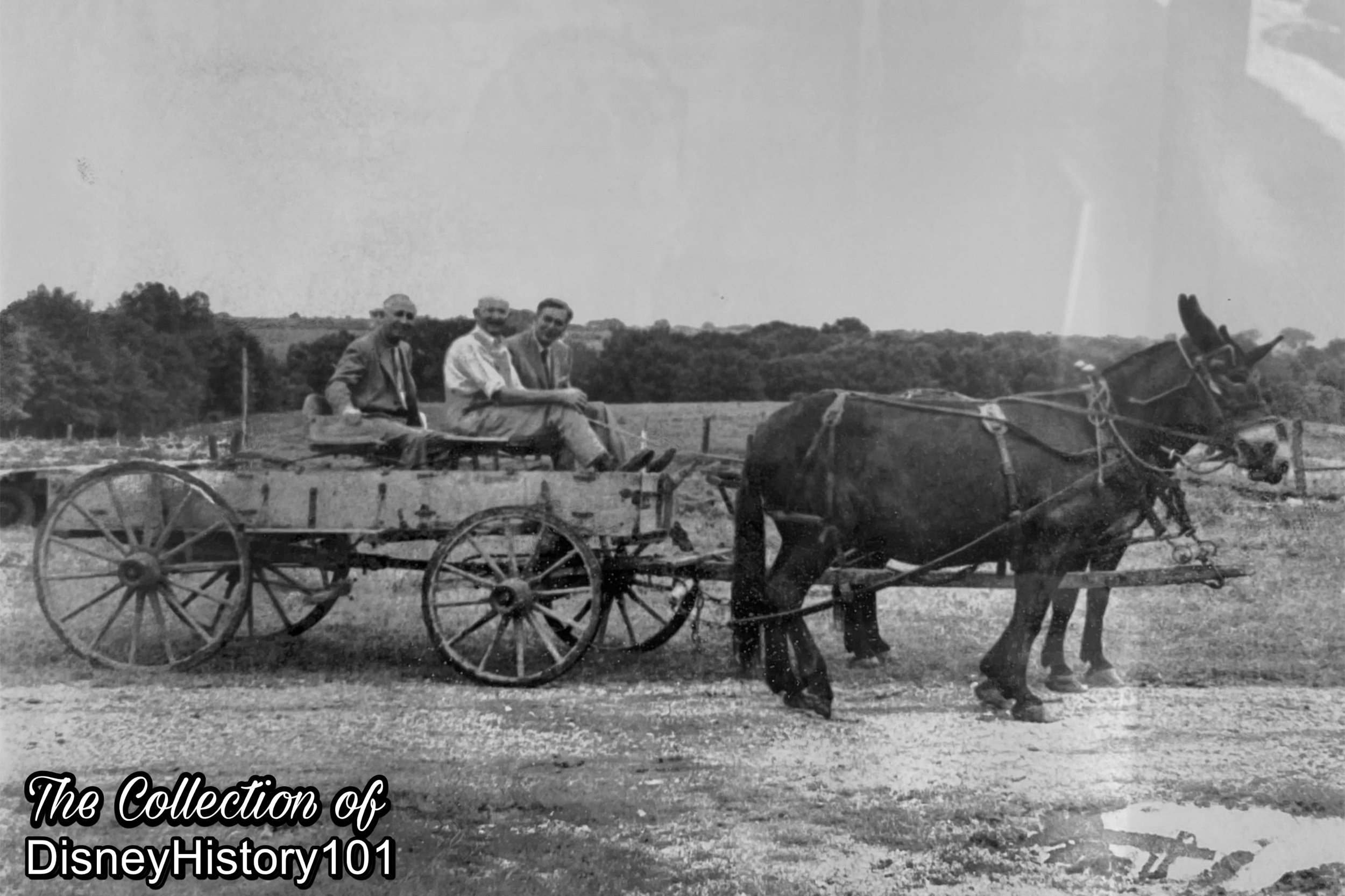
In 1906 Frank had delivered fence posts to the Disney Farm in his Peter Schttler Wagon. When Walt and Roy came back for a visit in 1956 (not long after the reopening of the Pack Mules at Disneyland) they enjoyed a ride in the very same wagon pulled by mules.
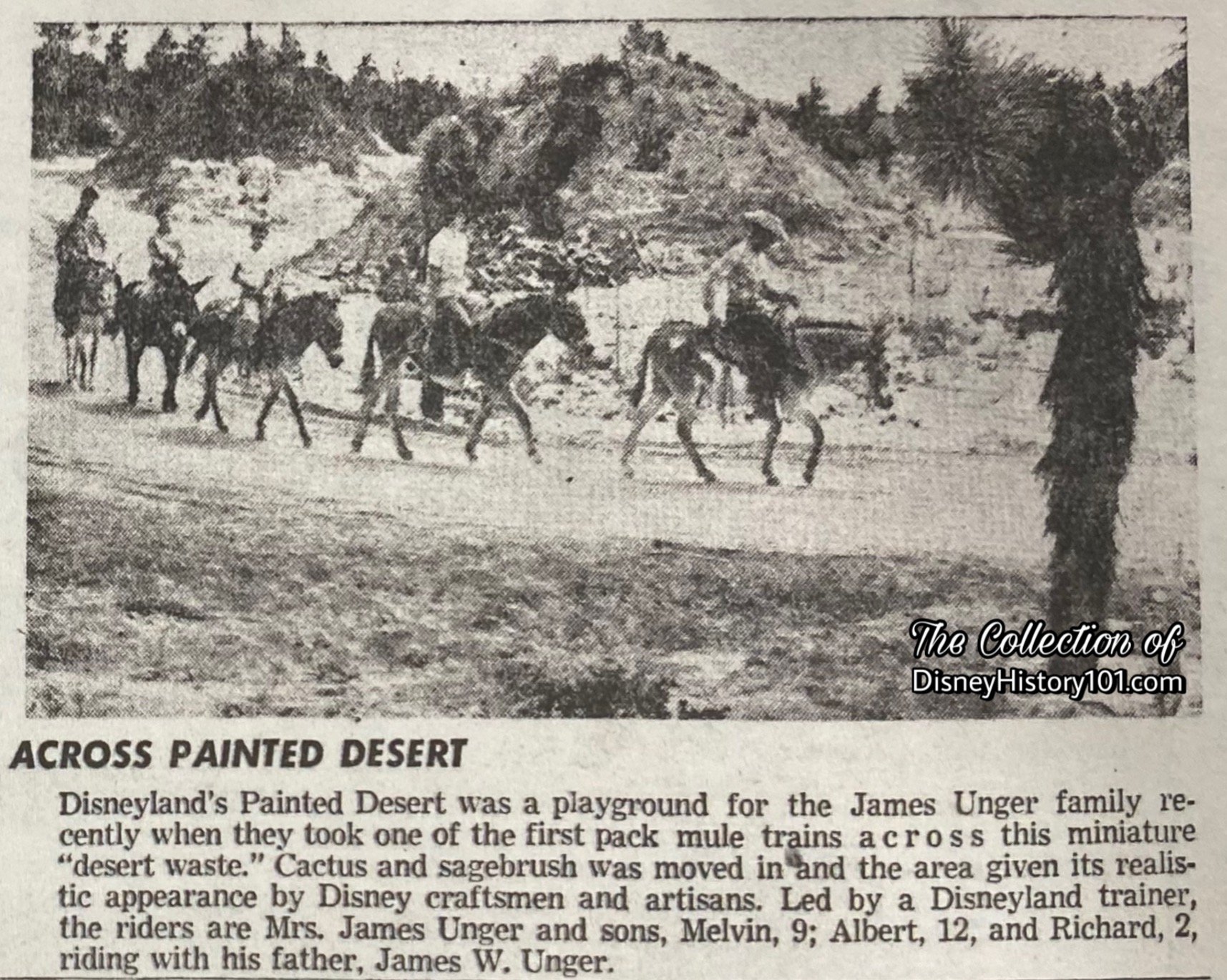
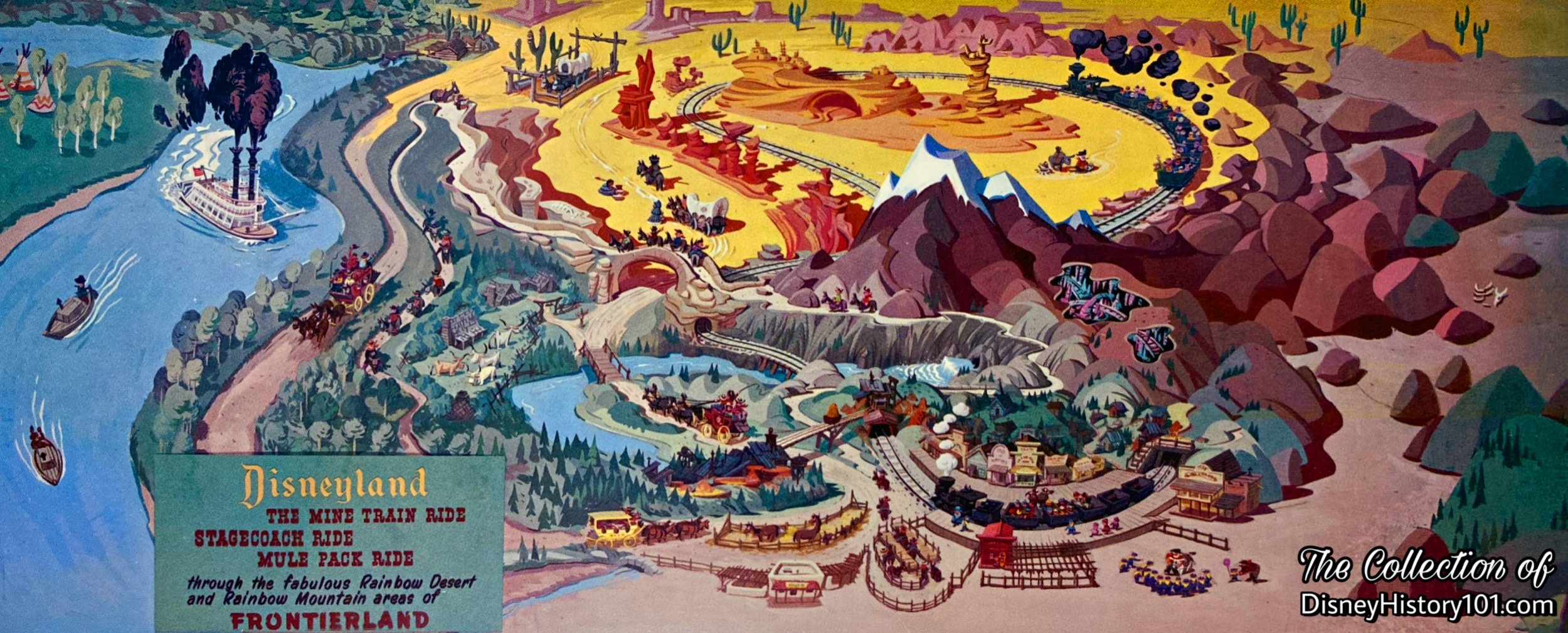
Just outside the mining town of Rainbow Ridge sat the boarding station for the pack mule train. Now, there were “three wonderful ways” to enjoy the Painted Desert at Disneyland.
This is a Walt Disney Artist's conception of a section of FRONTIER-LAND in Disneyland, featuring the awe inspiring Mine Train Ride, the exciting Stagecoach and Mule Pack Rides, where one can journey through the many fantastic sights of the Rainbow Desert and Rainbow Mountain areas, returning with a view of the famous Mark Twain River Boat and Tom Sawyer Island.
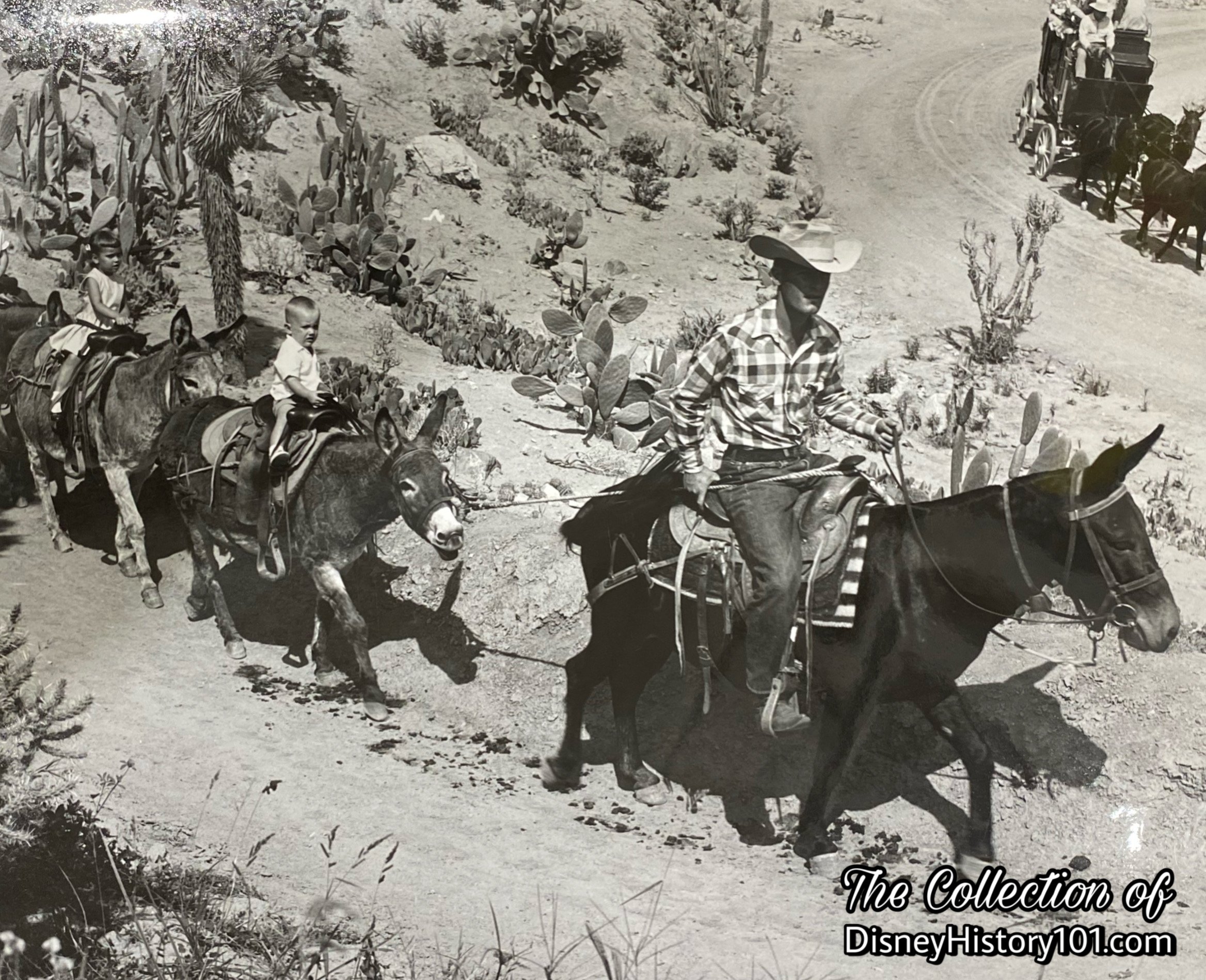
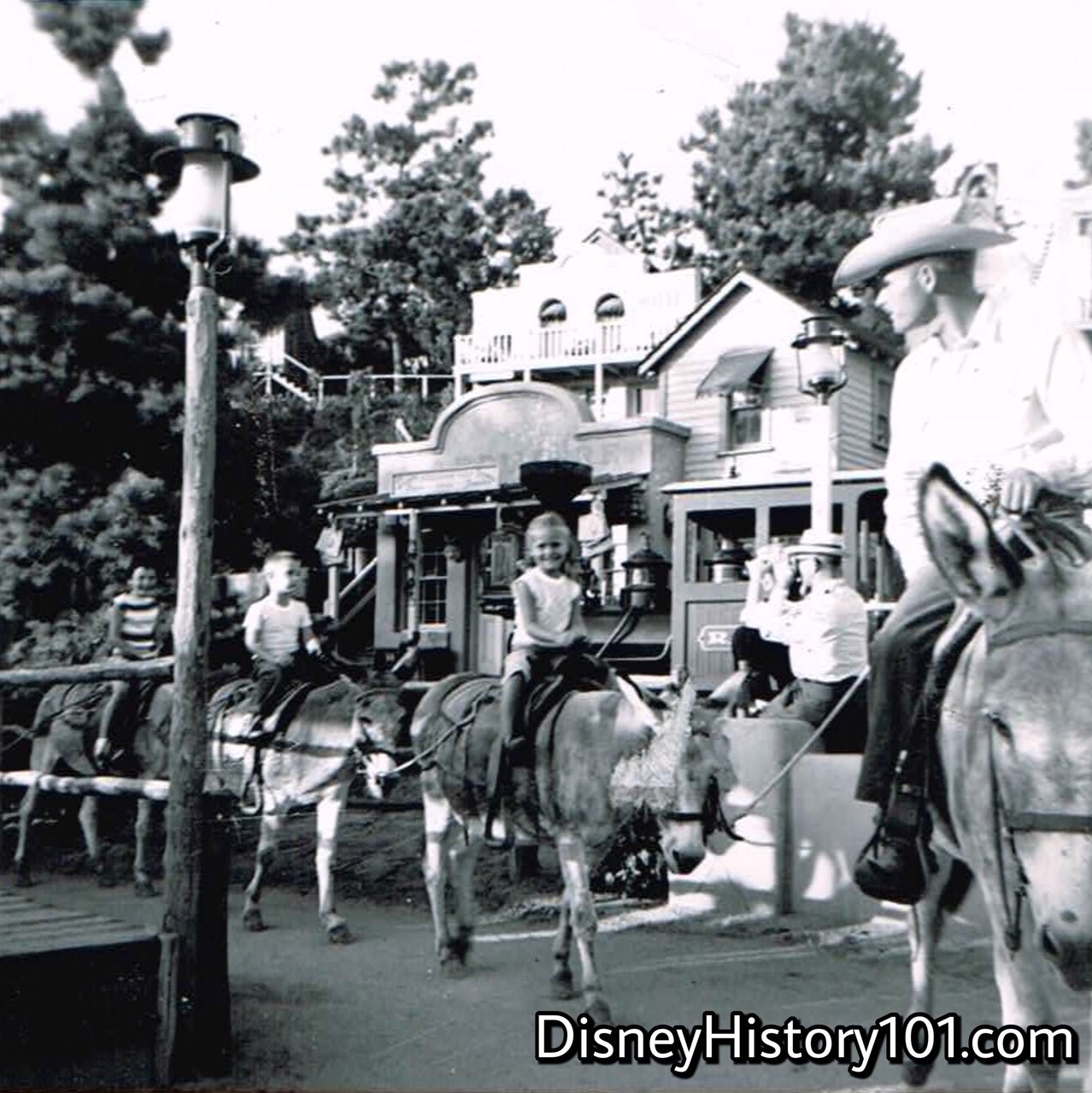
Similar to the Mine Train, the Rainbow Ridge Pack Mules also departed from the town of Rainbow Ridge!
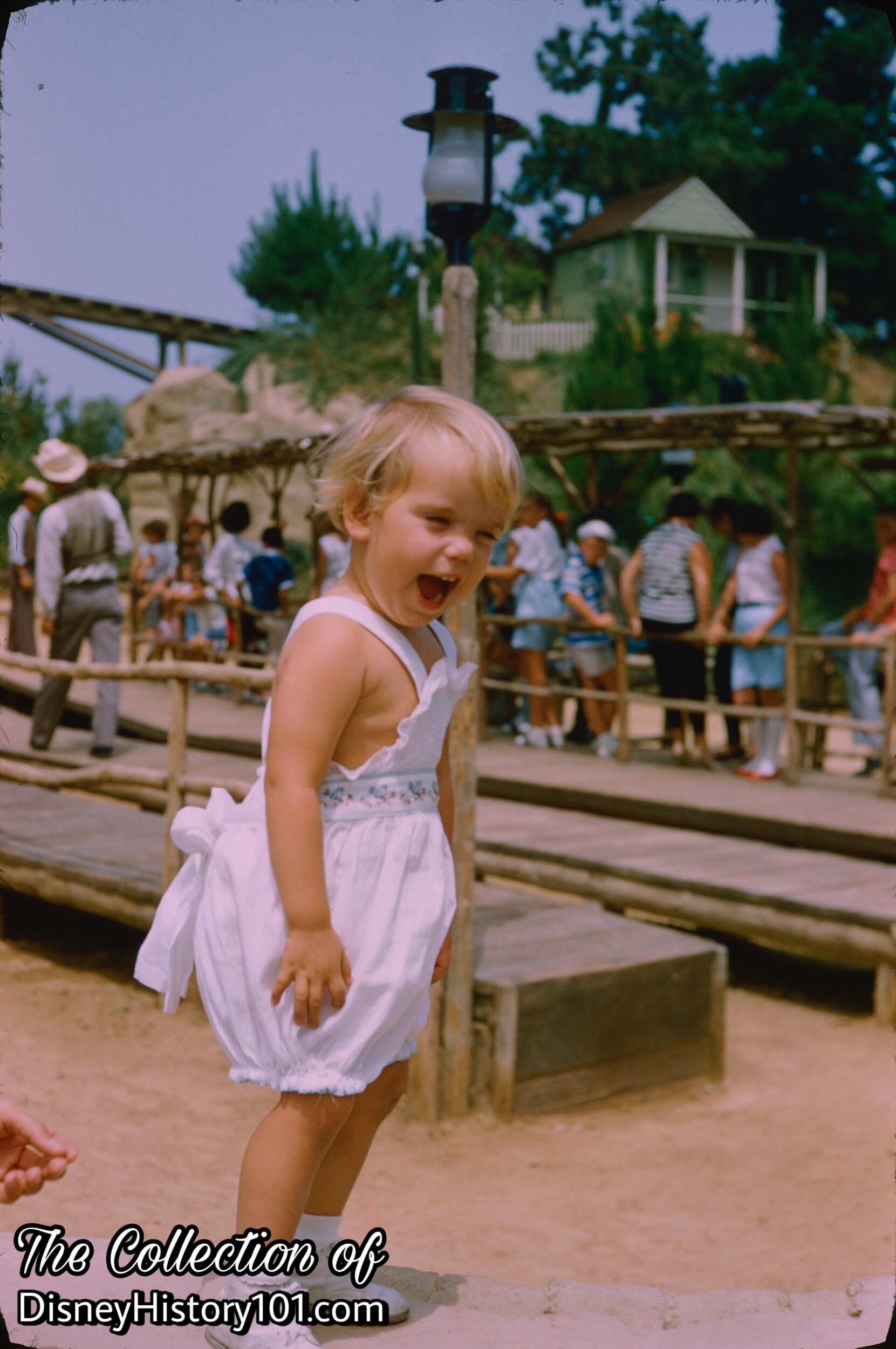
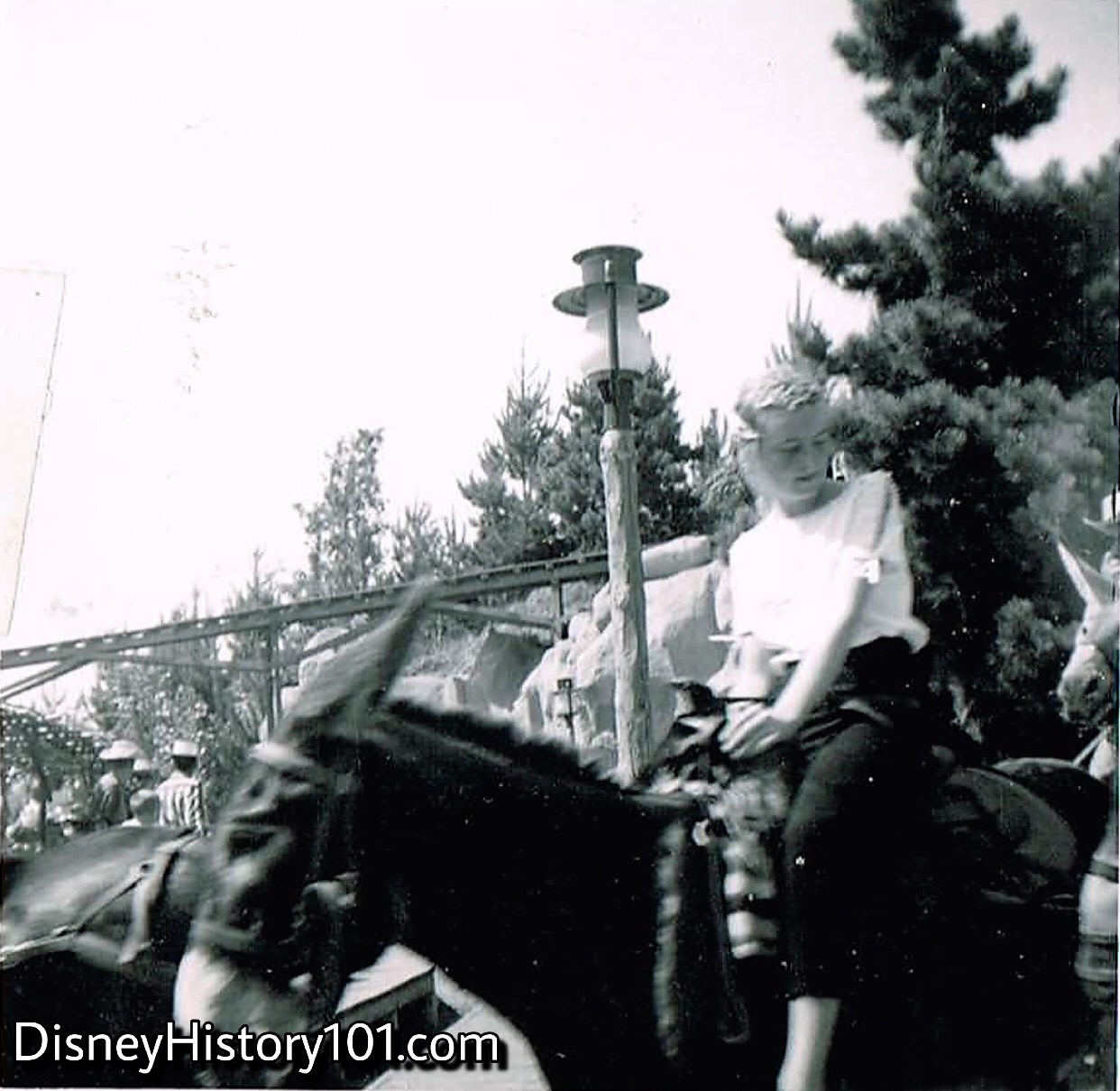
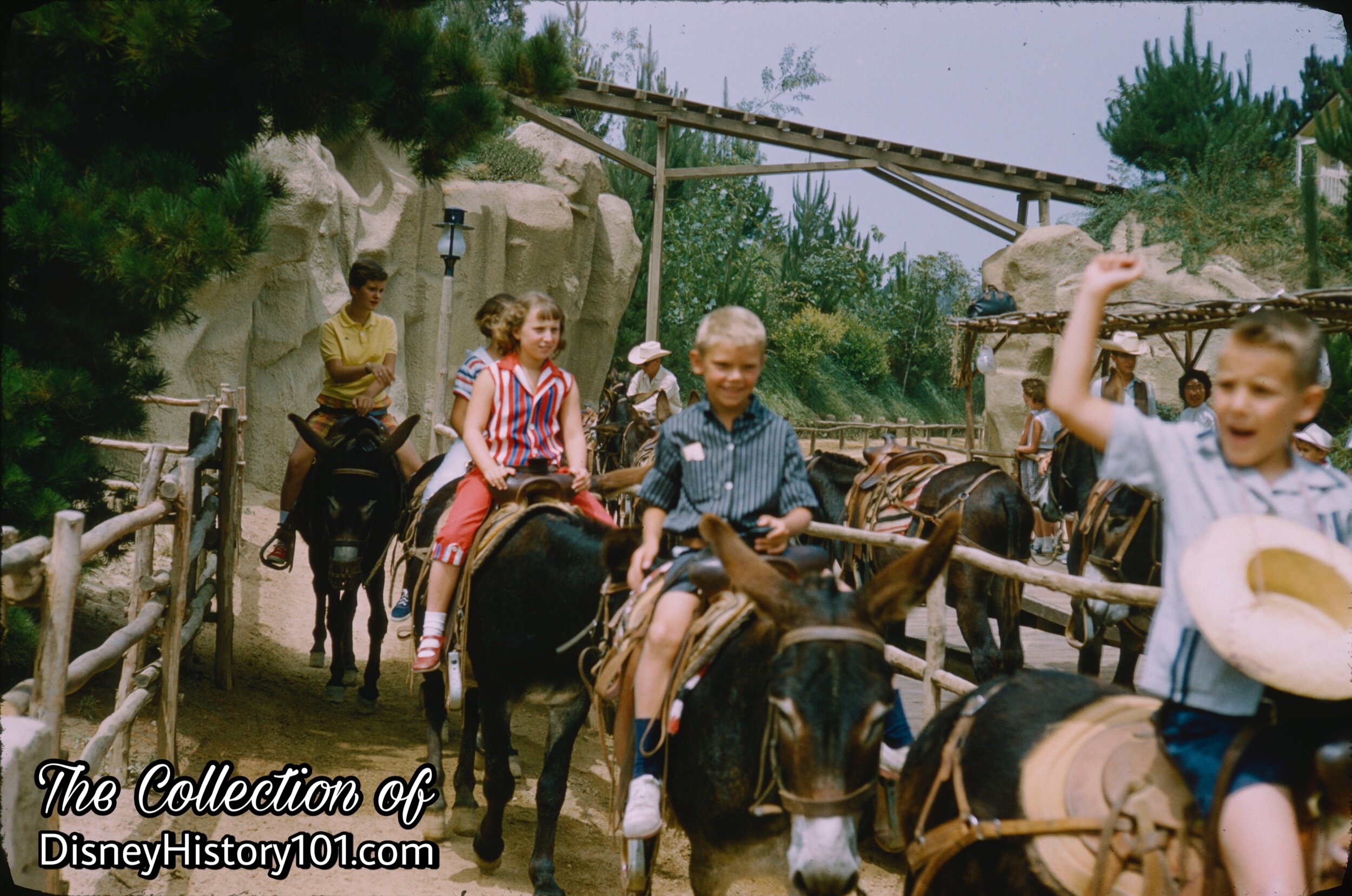
According to “Disneyland Inside Story”: “No animals in the Disneyland Pony Farm were more difficult to work with than the Frontierland Pack Mules. They began their show business careers by nibbling at guests' souvenir hats as they saddled up. When the operators got wise and started collecting the hats before loading, the mules occasionally retaliated by nipping shoes. One mule mistook a girl's long blonde ponytail for a ‘hay snack.’”
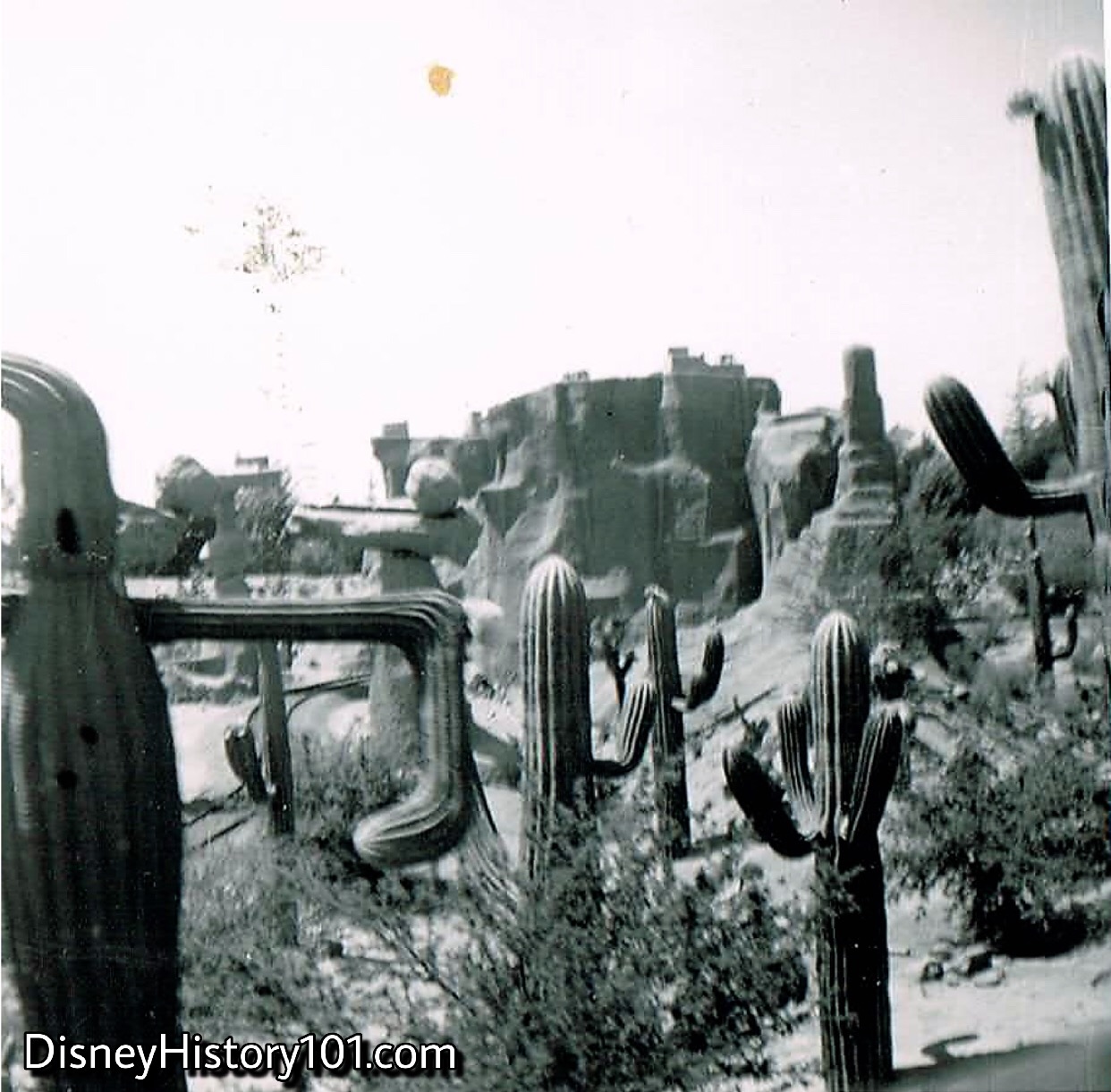
The Rainbow Ridge Pack Mules offered alternate views of the Painted Desert along a route not taken by the ore cars.
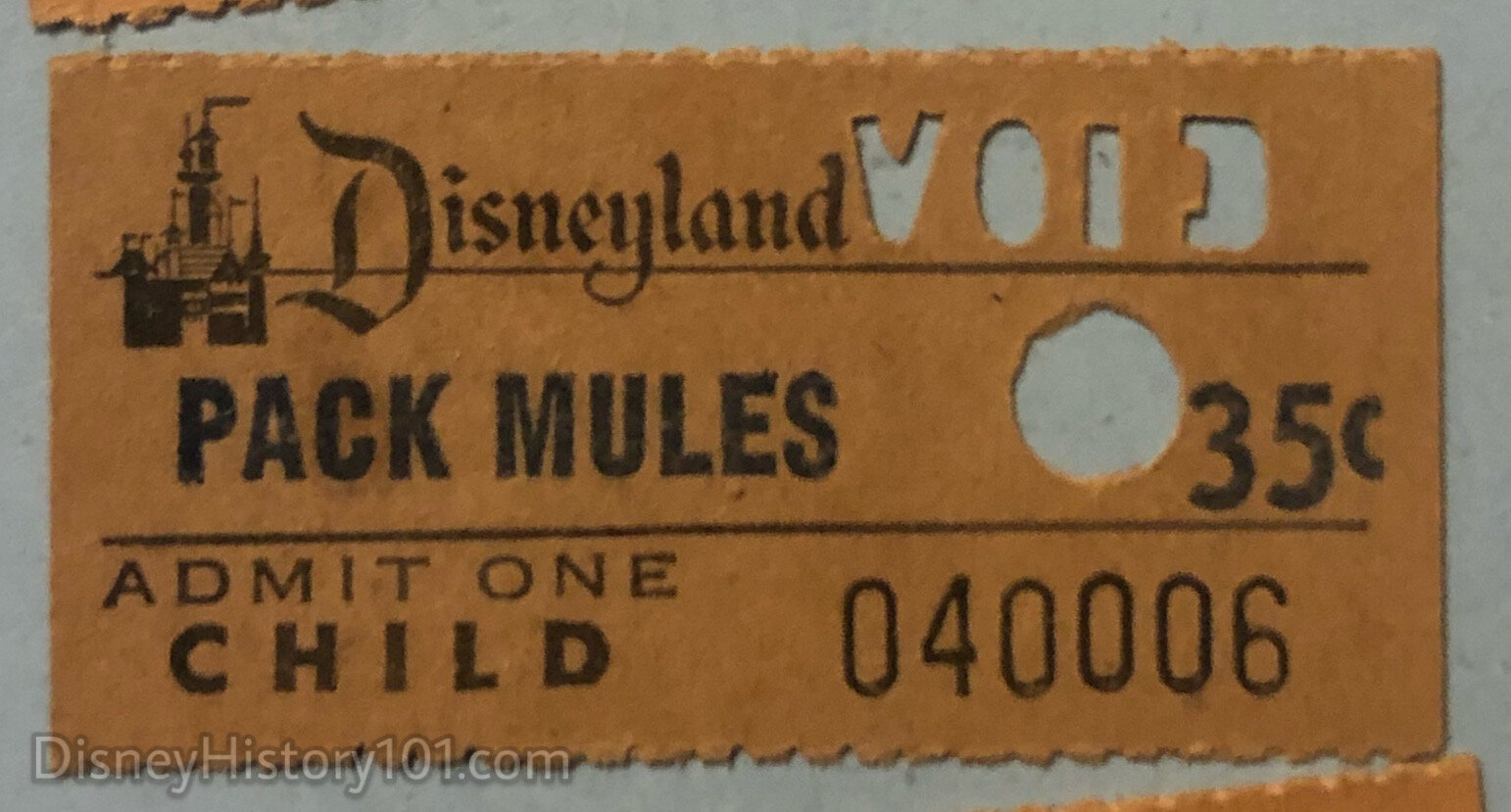
The tickets (like the ones for other early attractions), were likely produced by Globe. According to James Keeline, “The price [for ADULT and CHILD admission] stayed the same for the first few years but the lettered individual tickets started to appear in this era too.”
“‘VOID’ was used when they wanted to have tickets to put on display in the park ticket booths if people wanted to trade them in towards passports, etc.”
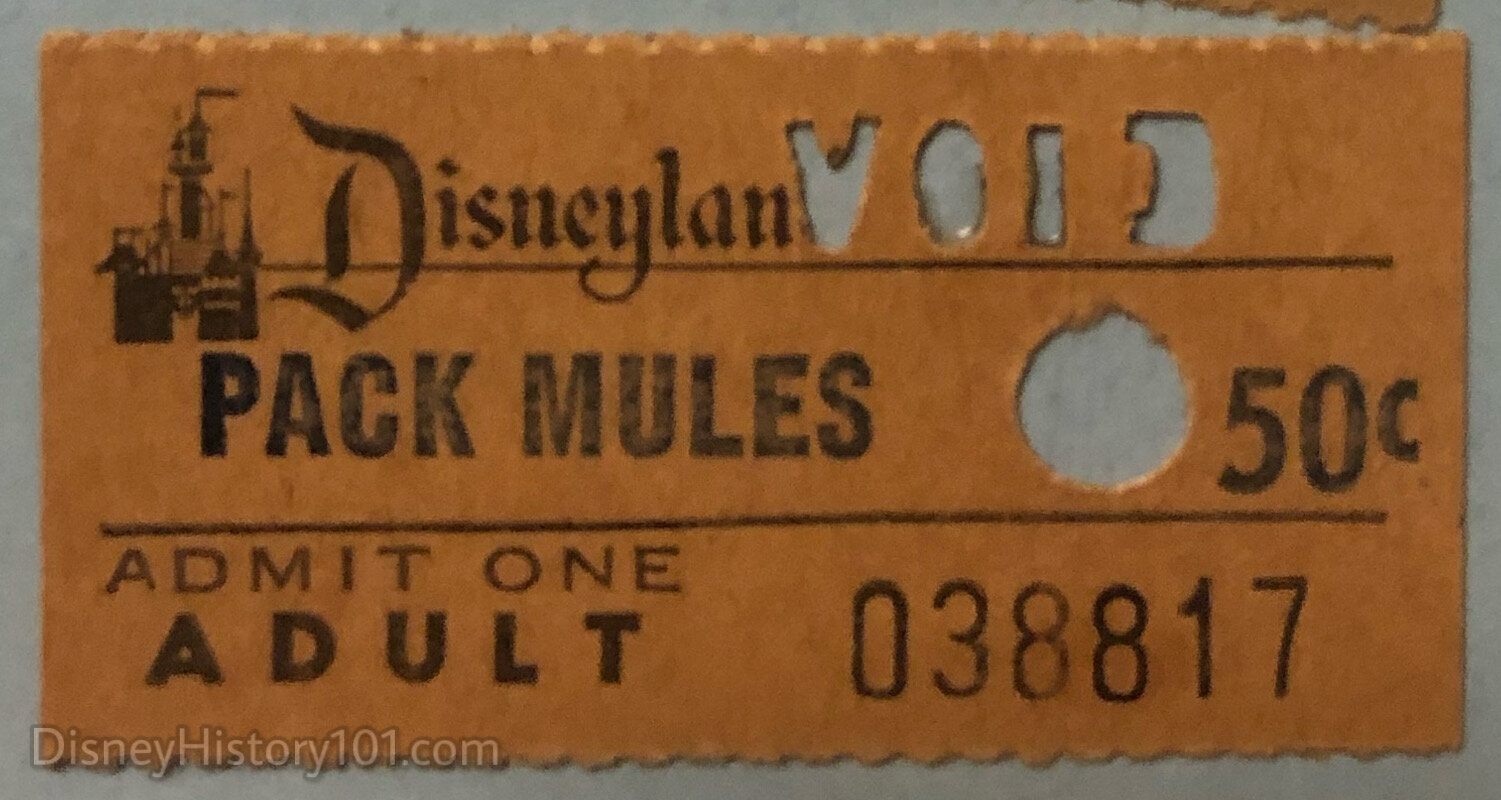
Admission during 1958 just was one “jumbo” “D” coupon (the price of 35 cents, for one child), the same as the Jungle Cruise, Indian War Canoes, or the Tom Sawyer Island Rafts.
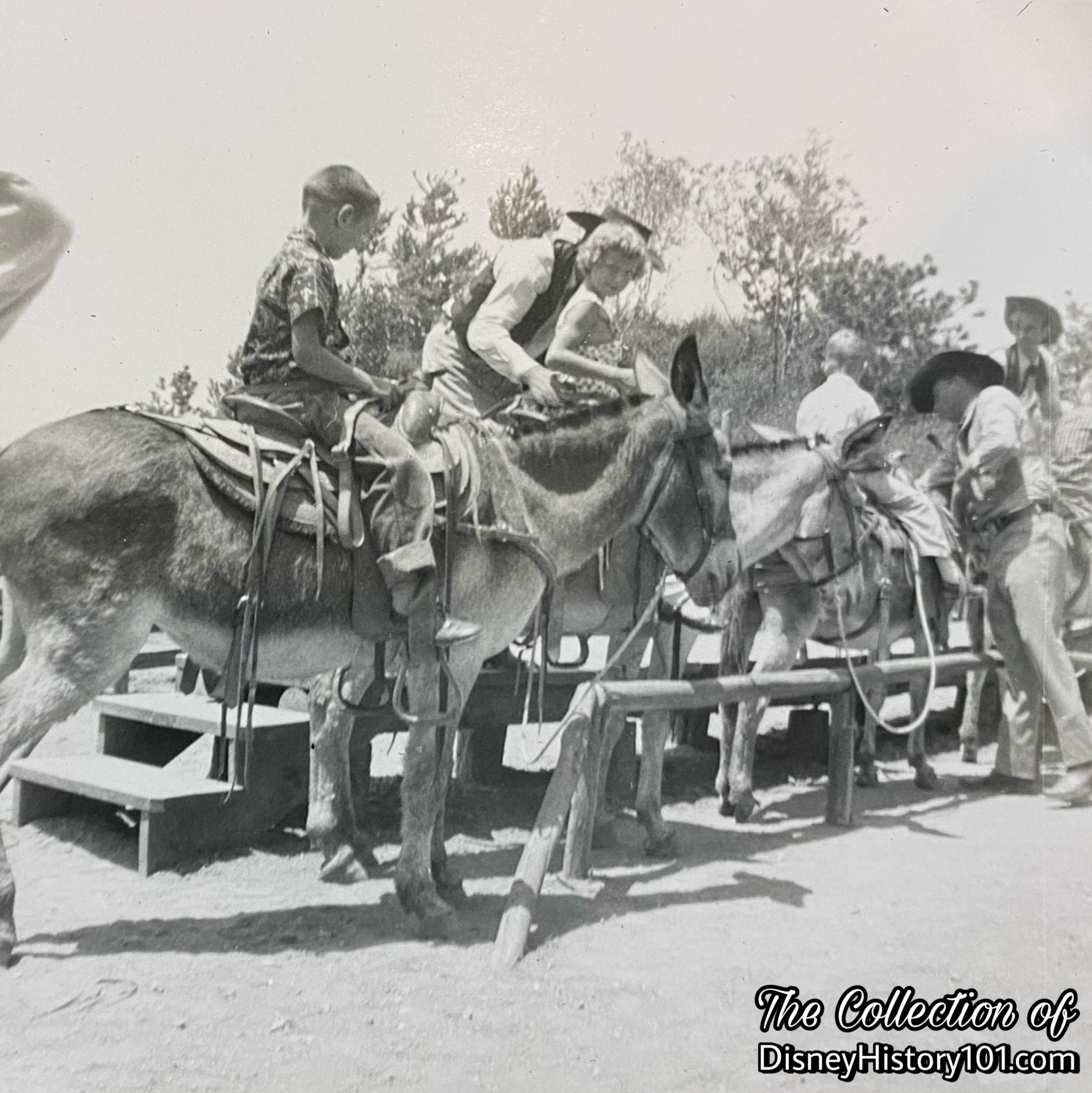
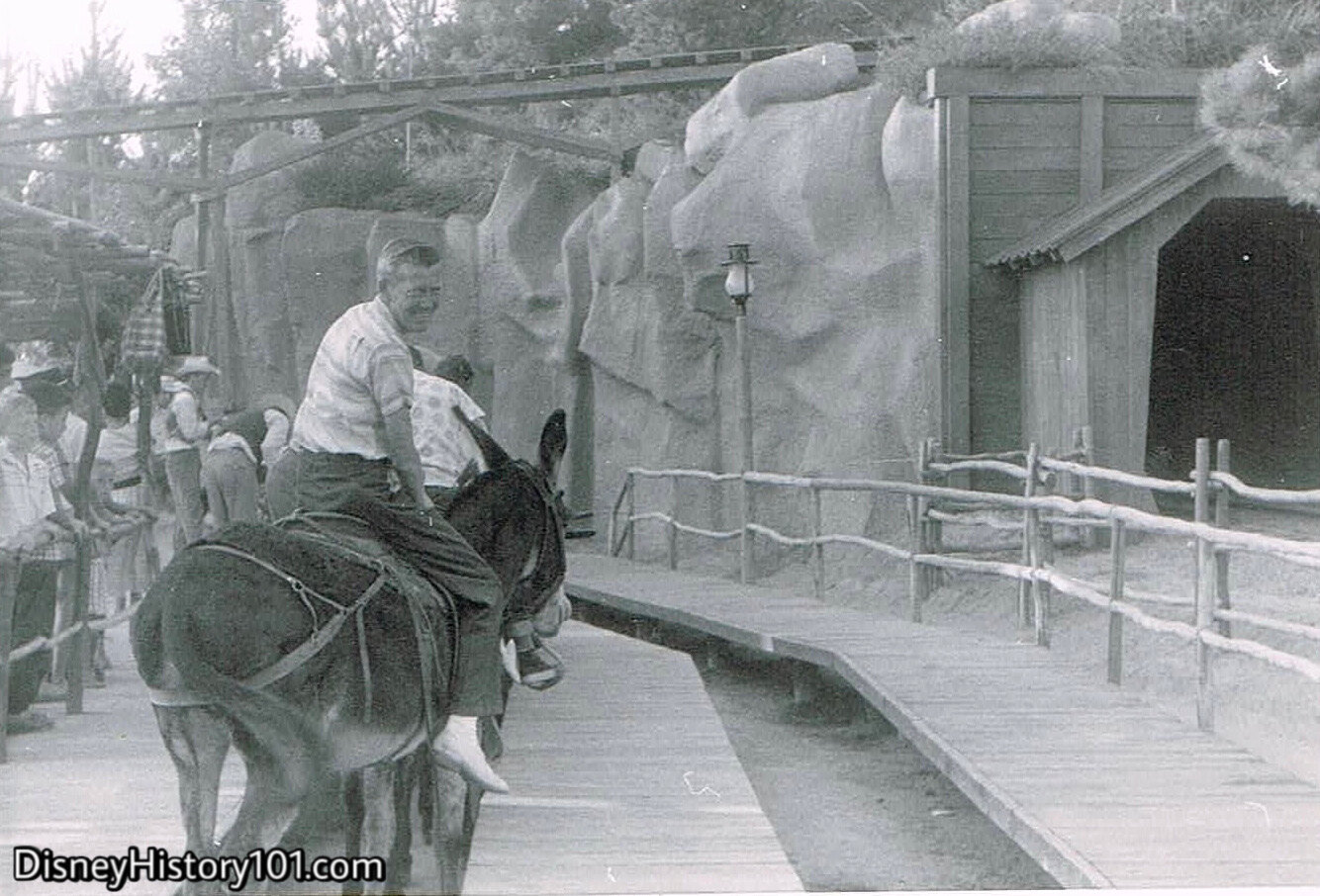
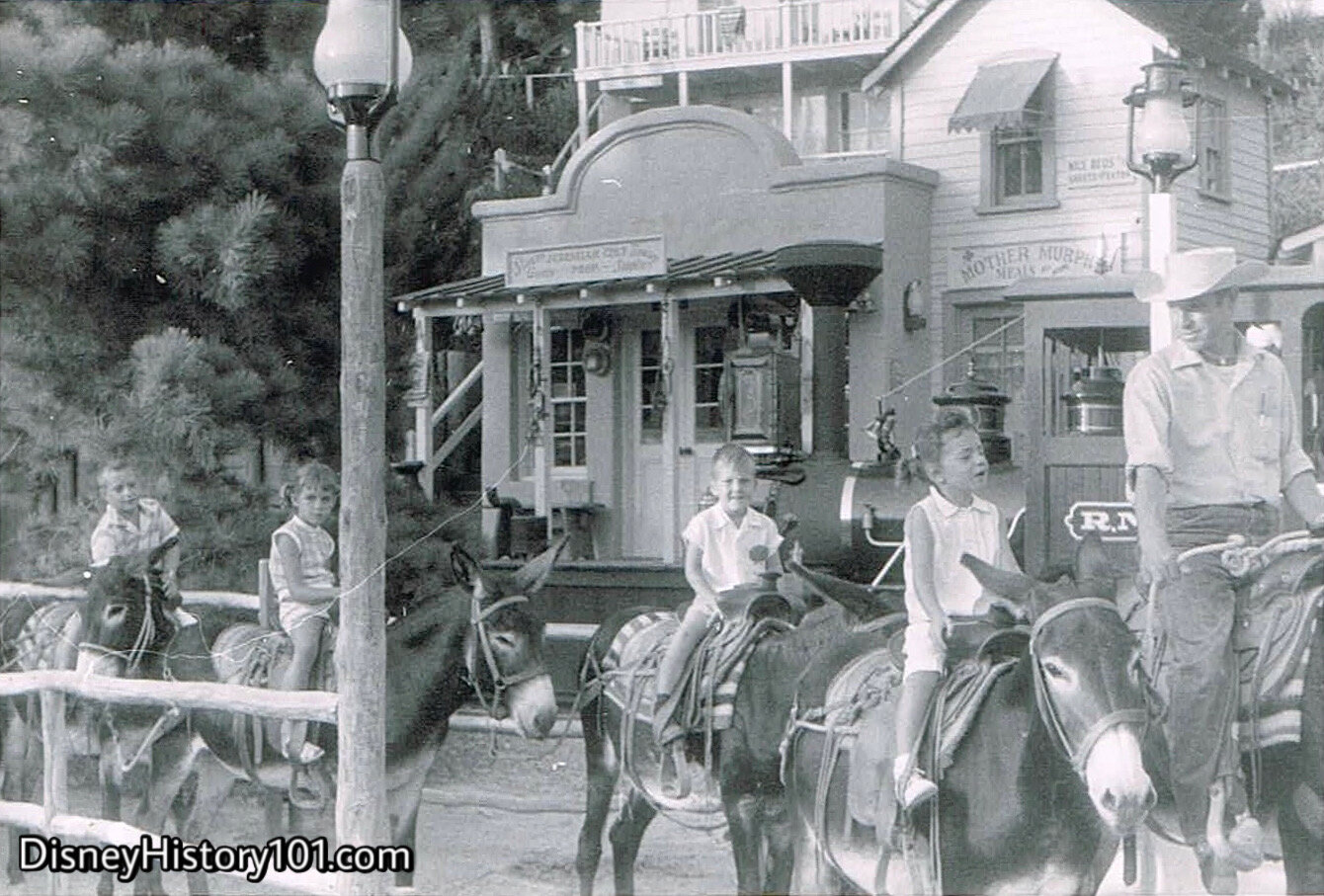
While some prefer the gondolas of the Mine Trains, hardier pioneers find a tour of the desert via sturdy pack mule more to their liking!
In order to assure an adequate amount of transportation, mules and burros were kept at two locations. This is evident by reports of an appraisal was conducted (from 1958 to 1959) through Bank of America, to qualify Disneyland, Inc. for a loan that would support a massive expansion of Disneyland.
During 1958, a couple of Bank of America District Appraisal Officers (William Smith & K.E. Johnson) appraised the livestock owned by Disneyland, Inc. Located in Disneyland, Orange County were found five small mules (ages 4-7; valued at $125 each) and 50 burros (ages 4-10; valued at $50 each). Other animals were pastured at Rock Creek Ranch in Llamo, California. There, were 35 burros (valued at $35 each) and five small crossbred mules (valued at $75 each) subsiding on pasture grass and alfalfa. A final account revealed that there were 88 burros (3 at Disneyland, 85 pastured) and 11 mules (4 at Disneyland, 11 pastured).
Appraiser representative (e.g. K.E. Johnson) of the District Appraisal Officer (J.C. Biggers) of the Bank of America Fullerton Branch was sent to Disneyland in November of 1959 to inspect assets including the related equipment and livestock. In addition, the mules and burrows were also appraised - one mule gelding valued at $100 a head; two burrow mares valued at $50 a head, totaling $350; 4 burrow geldings valued at $50 a head, totaling $200.
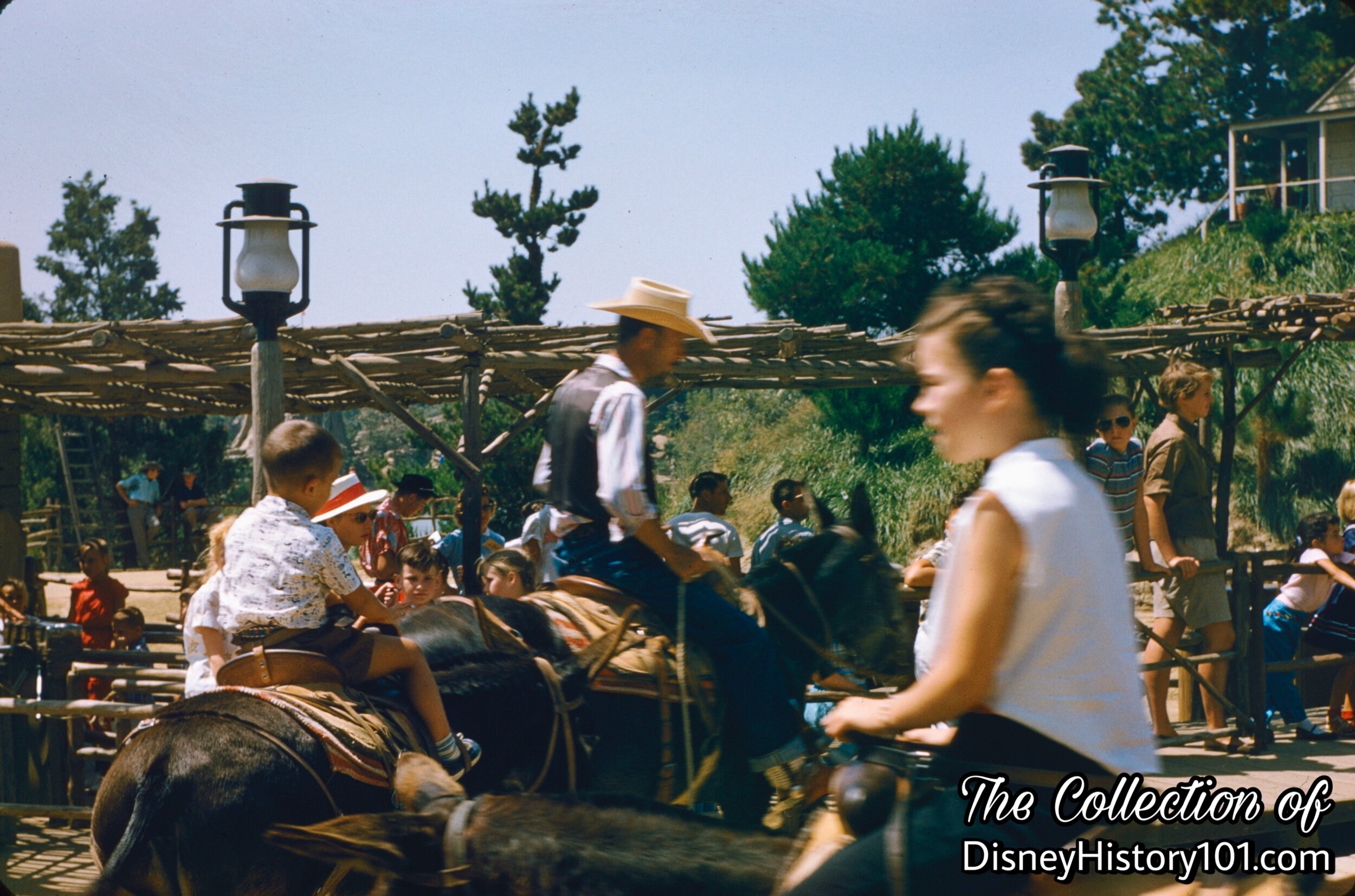
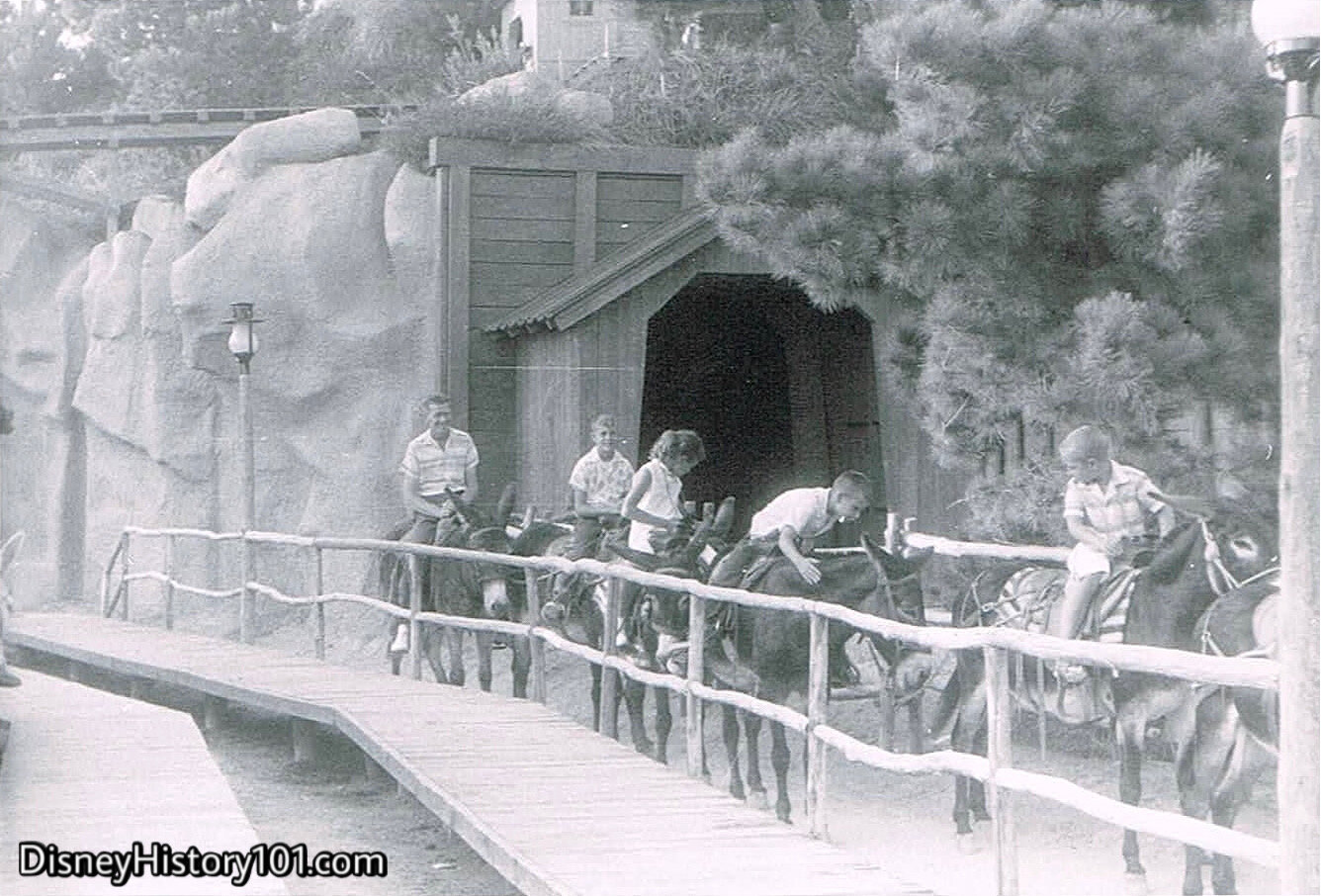
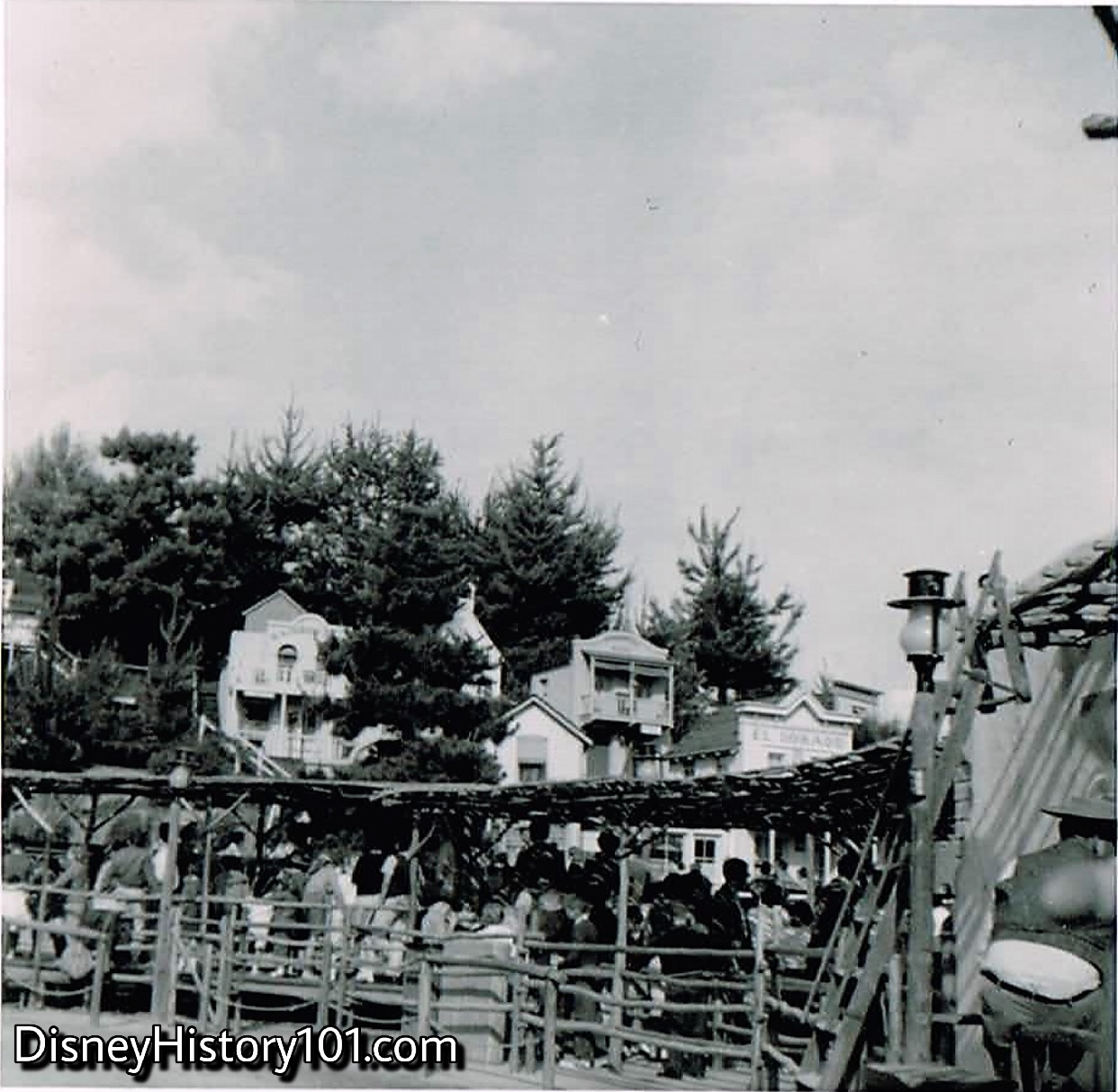
The Rainbow Caverns Mine Train attraction (of 1956) brought scenic “natural” wonders to the mule train route. That same year, a covered awning (similar to the ones in the Mexican Village) was added to the queue to protect guests from the rays of the sun before ‘saddling up’.

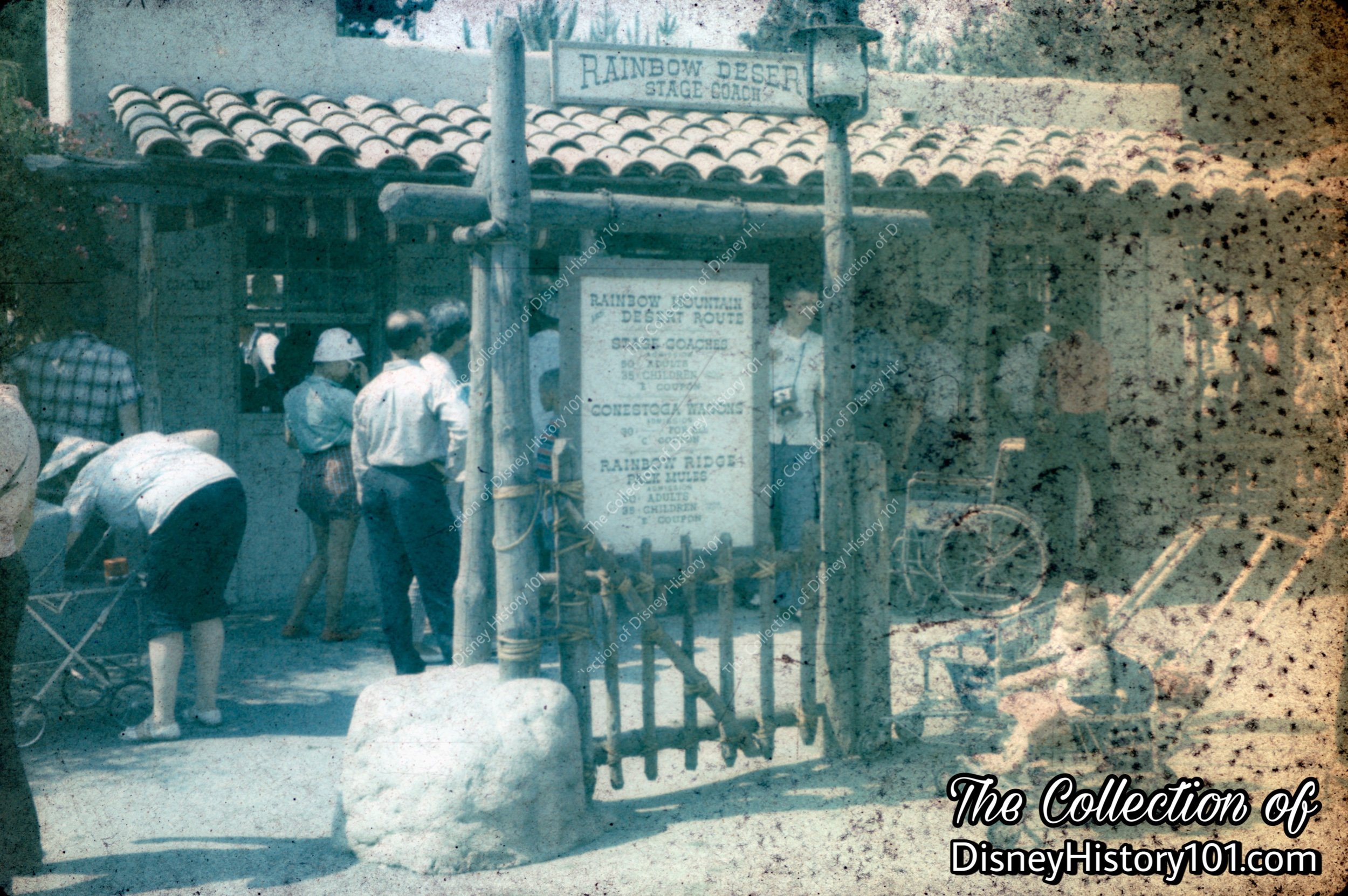
Once upon a time, Mule Packs, Conestoga Wagons, and Stagecoaches transported guests through the Rainbow Desert. This was the scene until July of 1959, when the horse-drawn vehicles began to disappear from Frontierland. During that year of 1959, Joe Fowler was Vice President of Disneyland Operations Committee and Doc Lemmon of Disneyland Operations was overseeing Operators of Rides & Amusements (like the Mule Packs, Conestoga Wagons, and Stagecoaches), Livestock, Parking Lot, and Ticket Sellers.
By this late date of October 4, 1959, several related direct purchases had been made including “16 saddles special rigged with a 14” seat” valued at $1,248. That very month, the first printing of the internal publication “Disneyland Dictionary” described the adventure in this way: “Pack mule ride into the mother-lode country of old West on mules such as were used by gold miners and settlers of the era.” By this time, the Rainbow Ridge Pack Mules consisted of two (2) packs - one (1) lead horse and nine (9) mules in each pack.

*Some sources state February 1st, 1973 and December 9th, 1973, while Disneyland LINE asserts October of 1973.
In 1960, a brand-new “seven acre composite True-Life Adventure called Nature’s Wonderland” would be “based on elements of four Disney films - Beaver Valley, Bear Country, The Living Desert and The Olympic Elk… a journey by mine train or pack mule into a wilderness populated by more than 200 life-like animals, birds and reptiles,” according to “Walt Disney Disneyland,” page 44, printed by Officine Grafiche Arnoldo Mondadori - Verona; first published 1964. Yes, the mules would now embark along a trail that offered alternate vantages of The Living Desert and the rest of Nature’s Wonderland! Youthful explorers could now see the “back country” of Nature’s Wonderland from the back of a sturdy and sure-footed pack mule, from dawn ‘til dusk.
As quickly as the Bounding Big Horn Sheep appeared atop Cascade Mountain (among the approximate 200 critters), it quickly disappeared so as to not threaten the mules. Precautions were also taken to not frighten the mules passing over Natural Arch Bridge. Operators would refrain from ringing the bell or blowing the whistle while the Mine trains passed below.
Back in 1957, Disneyland maintained around 200 head of horses, ponies, mules, and burros. Despite all the equine-powered vehicles at Disneyland, most of these “200” were mules and burros. By 1962, Disneyland had a total of 195 horses and mules [according to an article by Art Linkletter published in The Ford Times Guide To Travel In The USA, published 1962]. Of course the latter figure still mostly included the mules and burros (98 mules and 68 burros were most of the head of horses kept by Disneyland by the summer of 1966). One may wonder why there were so many mules on hand and the reason is because the Mule Trains consisted of eight mules, and there were as many as “10 trains running during the summer” seasons, accruing to Backstage Disneyland (Summer, 1966).
None of these animals worked more than 4 hours a day, six days a week. When they weren’t working, the horses were stabled in clean and individual tie stalls, while the mules and burros had their own corrals and lots. “They receive excellent care, as does everything connected with Disneyland. Gear is kept clean, polished, and in good repair. A full-time farrier is kept on hand, and barns, stalls, tackrooms, and corrals are kept spic and span”, [according to The Western Horseman, published September of 1957].
According to “Disneyland Inside Story”: “Although blessed with extraordinarily short work hours, the mules would stop for no apparent reason along the trail and refuse to continue, regardless of the verbal lashings applied by the mule skinner. And almost anywhere, at any time, one of the creatures would break into a loud and repetitious series of brayings that sounded astonishingly like ‘hee haw.’”
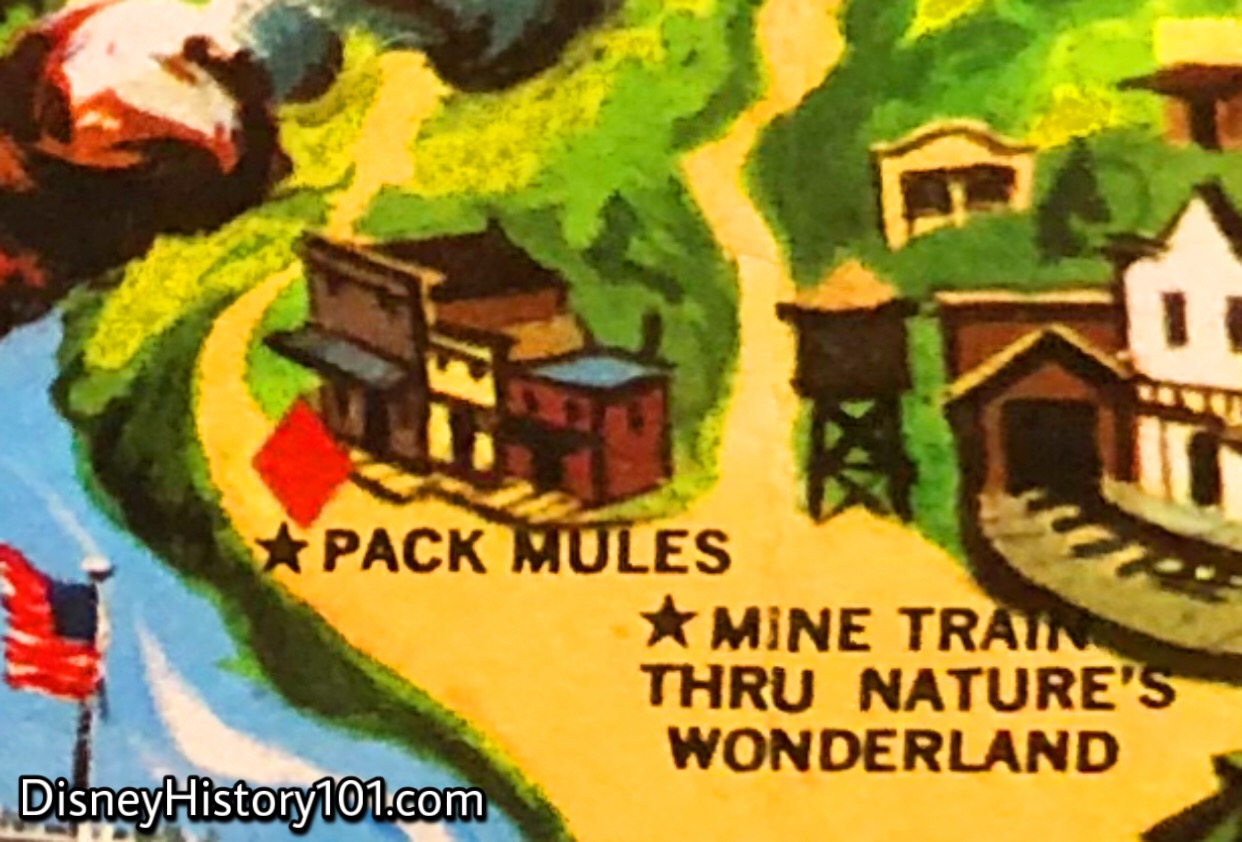
In 1965, Backstage Disneyland published the following short report: “Famous Mule Master, WALT BRICKER, placed his feet comfort ably on his ‘desk’ in the old Blacksmith Shop at Rainbow Ridge. ‘Yessir,’ he mused, ‘It was quite a Summer. Had one of the finest crews in the Park. Broke the ride record on July 14 with 3848 guests carried. The riders and loaders operated together as a team.’ Then he told how the operators were all taken to Owen Pope's Pony Farm to see the magnitude of the Disneyland equestrian operation. The mules consume a ton and a half of hay a day and, thus, must work to pay for their keep. Each rider lines up his (or her) string of mules and then combs, grooms and saddles each one.
JIM LINDSAY, foreman of the riders, is tremendous with the animals and calls every mule by name. He personally rides every new mule to see if he is safe for the guests. If a shoe becomes loose on one of the mules, Jim opens his old tool chest in the Blacksmith Shop and removes the shoe.
Walt tilted farther back in his chair and his eyes twinkled. ‘Sure have some good looking girl riders,’ he beamed. And that CAROL SPAETH is a real sharp horse trader. Watch out for her.’ ‘And take that DANNY JOHNSON. She is quite a gal with animals. She can out work most men. She used to saddle forty horses at her father's stable before starting her shift at Disnevland.’ CHARLEY YATES is an old timer. He used to be a jockey. AL HOWRY used to ride for Betty Grable. FLETCHER SKELTON comes from New Mexico where he used to punch cattle. He still rides a horse as if he was on the range, spurs and all.’”
Another rehabilitation ended with an extended Loading Dock added for the summer of 1966.
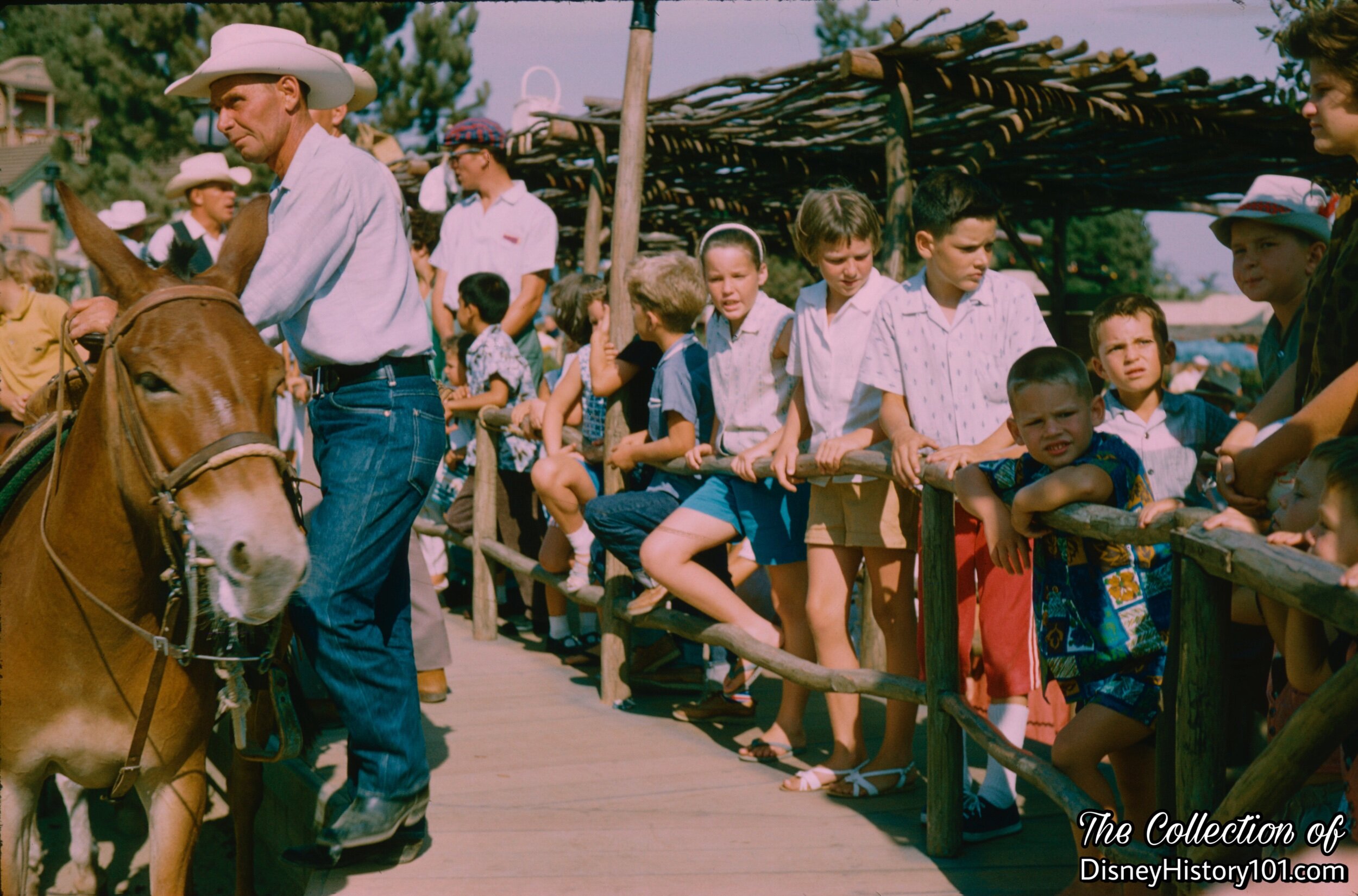
Charley Brock recalled: “Well, one day we were workin' 10 string o' mules in the Park and the Santa Ana winds got to blowin' Limbs were fallin' on the trail. There was a big tree at the end of the loadin' dock and it started cracklin. I stopped loadin' and I was scared and shakin' as the tree kept creakin. I had just got my last string out when the big tree fell with an awful crash!”
Disneylander and “55er” Frank Pfannenstiel went to work on the mules in 1961. Eddie Dixon also alongside the chute where his mules were bein’ loaded.
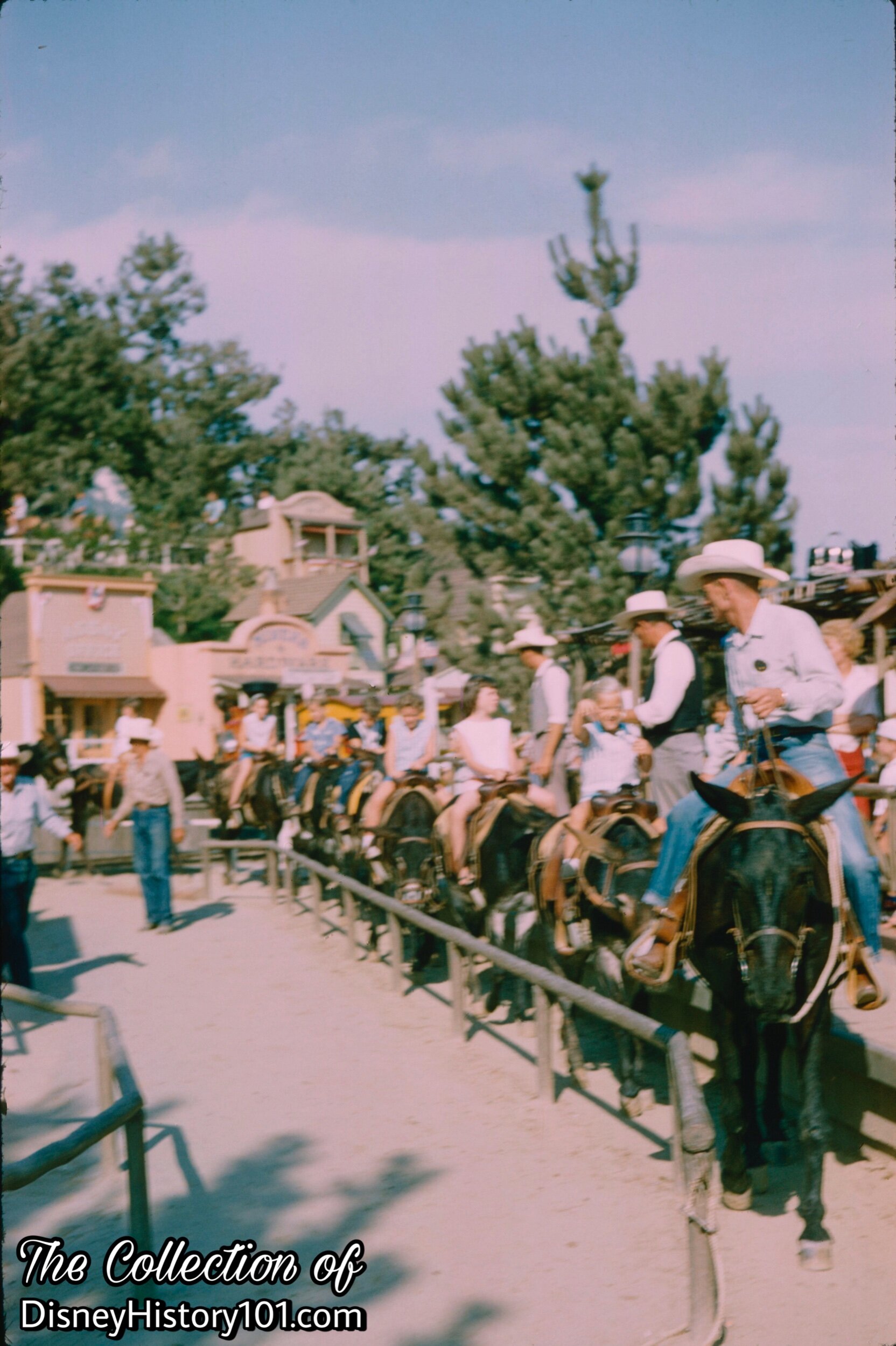

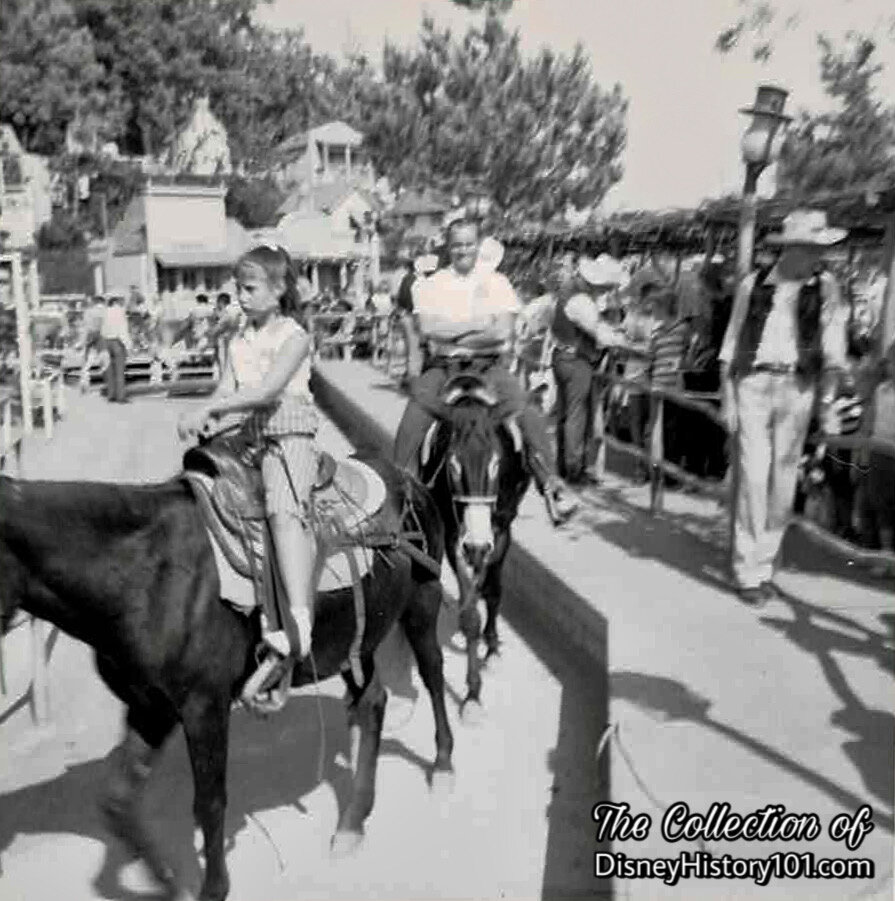
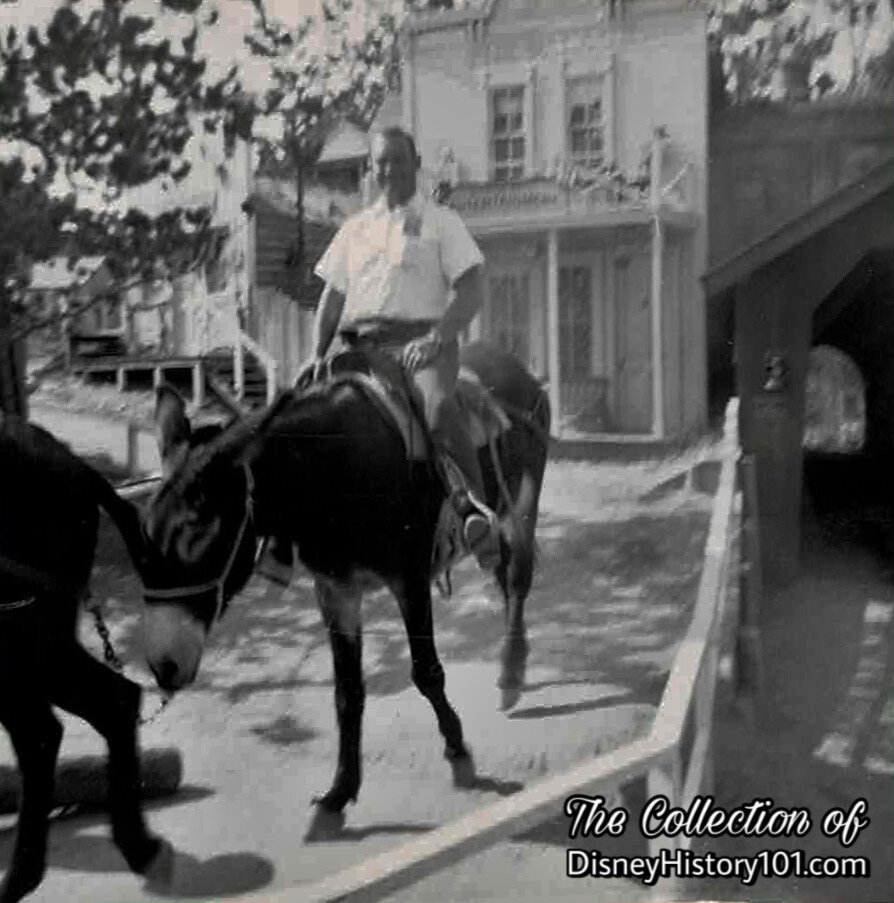
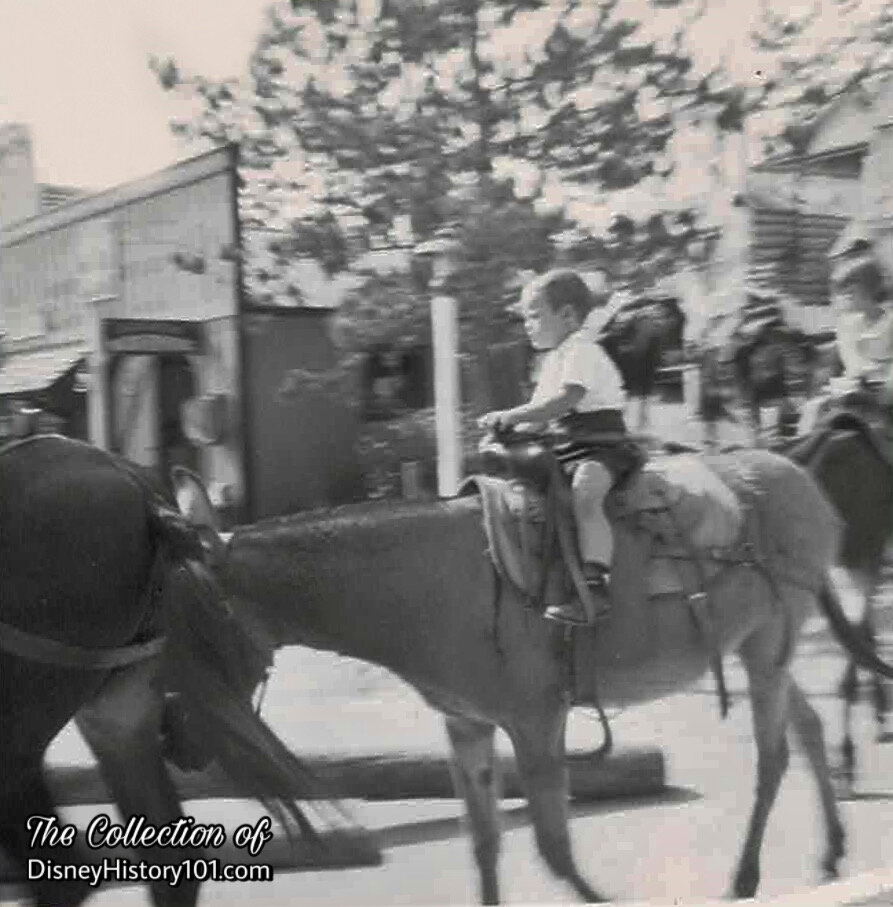
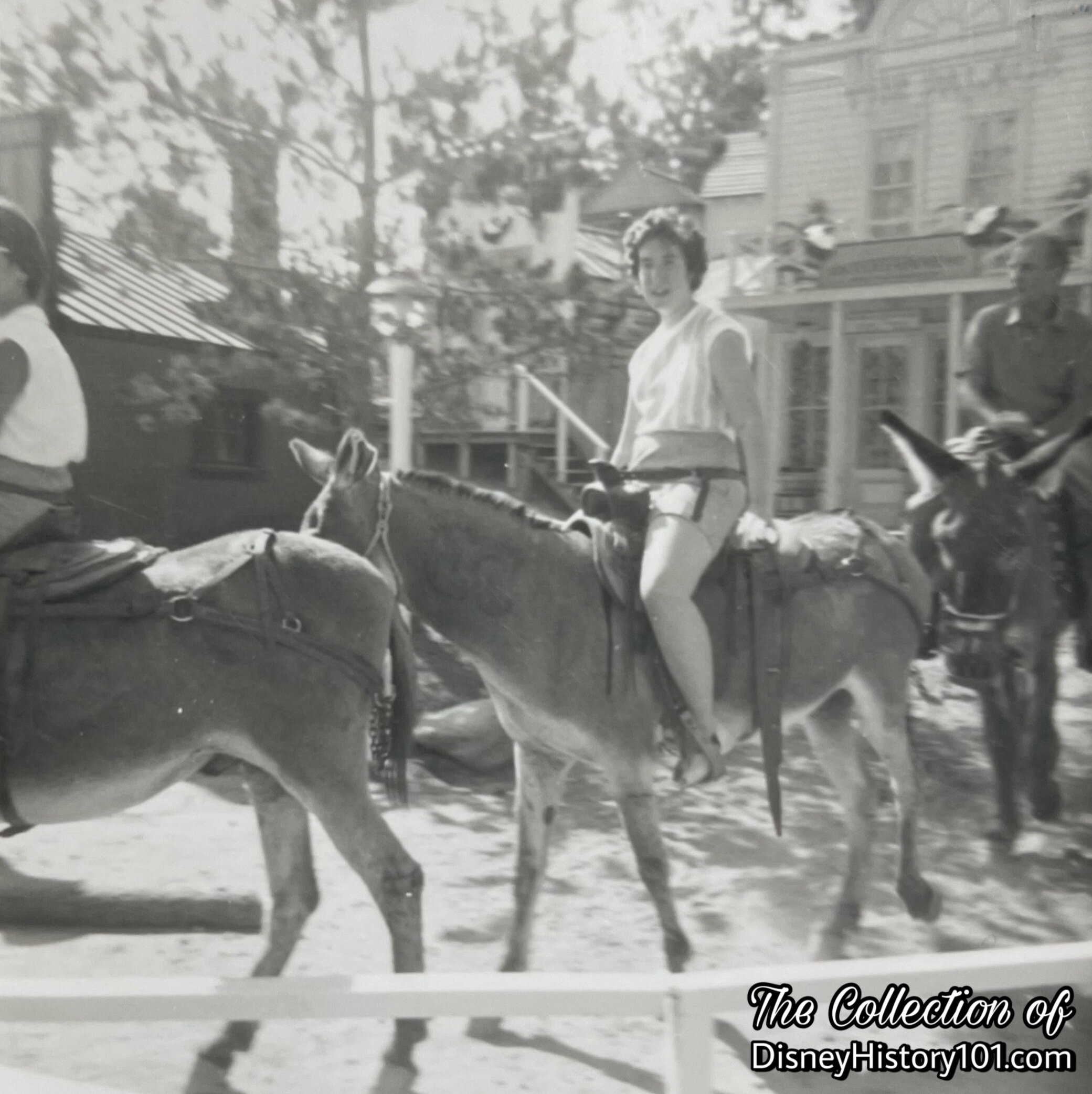
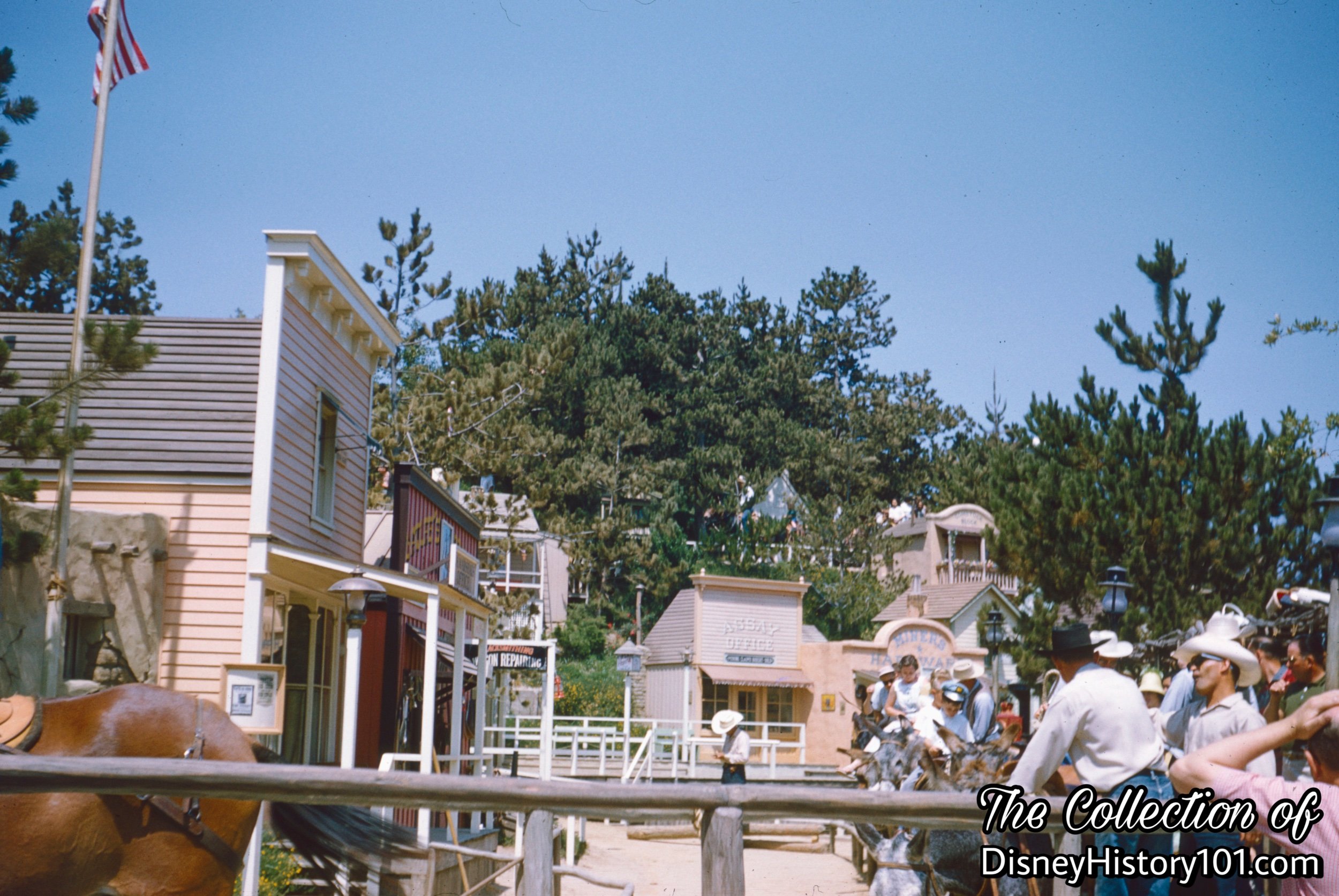
The Mule Pack Ride was occasionally featured in media. For instance, in August of 1962, Lloyd Richardson, Larry Clemmons, Joe Marquette, Coy Watkins, and Jack Leppert (of the Walt Disney Studio) filmed and shot scenery “(1) near the fighting stags, (2) behind a building in Rainbow Ridge and (3) on the Mule Train itself,” for Studio Production #3185.

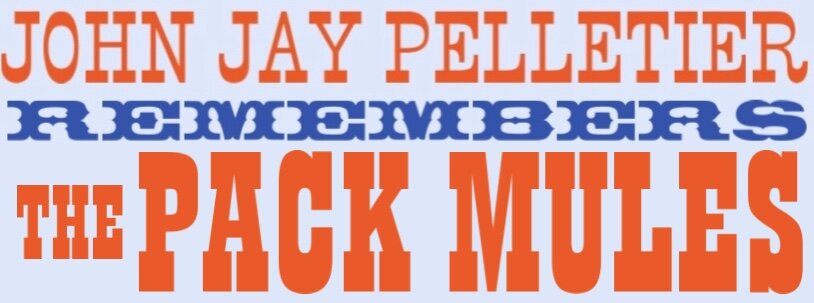
Many notable Disneylanders had a privileged part in the Pack Mule rotation - the set order of operating positions established by the attraction's Working Lead. Plenty of Disneyland Cast Members had their start as Mule Riders, like “55er” Charlie Brock, Mike Leslie (eventual successor of Disneyland Pony Farm Supervisor Day Sechler), Walt Joseph Jackson Brickner (who was often mistaken for either Walt Disney or the late Clark Gable), and Eddie Dixon (another c.1965 Cast Member). Many of these had a passion for working with equine and most animals, like John Jay Pelletier. This is John’s story :
“I had just come from canada in 1960 and gone from country living to city living. I think in 1961 dad had just got a new job and took the family to Disneyland. At that time they had Tom sawyer’s Island (and I enjoyed that), the canoes, and the mule train. I was 15 the first time I went. Mom and dad loved the jamboree and the Golden Horseshoe saloon. We had ice cream, pop corn, apple candy, and that sort of stuff. I remember the fantasy of it all, and the characters. That was my first experience with Disneyland.
Then there was a Grad Nite. The gal I dated was a senior, and I had never seen Disneyland at night. It was all lit up, and so pretty. I lived in Fullerton and if we got on top of the house we could see the fireworks at night. One of my teachers worked for Disneyland, and mentioned that Disneyland was hiring. A friend of mine said, “Do you want to go work for Disneyland?” Come middle of may of 1965, he got a job right away on the monorail, and the Horseless Carriages, and the train. I never got the call, and went to work with my dad in the oil fields. I got the call [later] in the middle of June, and they asked if I had experience working with animals and mules. They said we have an opening on the mule train, and the pay starts around $1.75 an hour 1965. So, I went to work for the mule train, and the next thing I knew, I had my own train. I would load the kids, get the animals, feed them a little, give them a break, and then get back in line and do it again.
Having been raised on a farm in Canada, I learned to saddle up horses and teams of Mules to pull logs out of the forest. So I felt at home…it was fun. The hardest part was to tell people that they were too big [to ride]. Kids were the best, …I spent time with each one while adjusting the stirrups. I always carried pieces of carrots in my pocket for the stubborn ones. Mertal always got excited when she would see me. She knew I had carrots for her.”
The Mule Team was particularly close. Charlie Brock recalled one Thanksgiving. “There was a girl rider, name of Margaret Karl, and she said that she would fix the turkey and everybody to bring the trimmings. She brought a tablecloth and set the table in the old mule shed. She had a 23 pound turkey, and we had olives, cranberries and punkin' pie!”
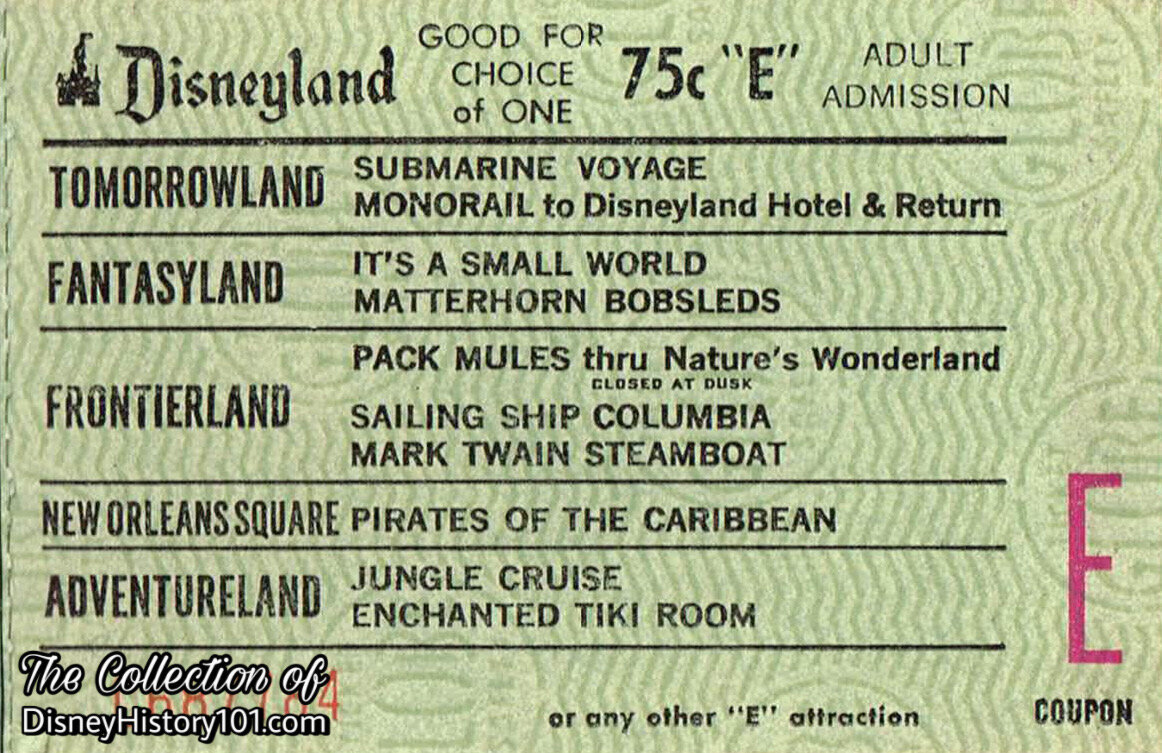
In 1965, the cast of admission for seeing Nature’s Wonderland from the back of a sturdy Pack Mule was exactly one “E” coupon, or 75¢ for adults and 65¢ for children.
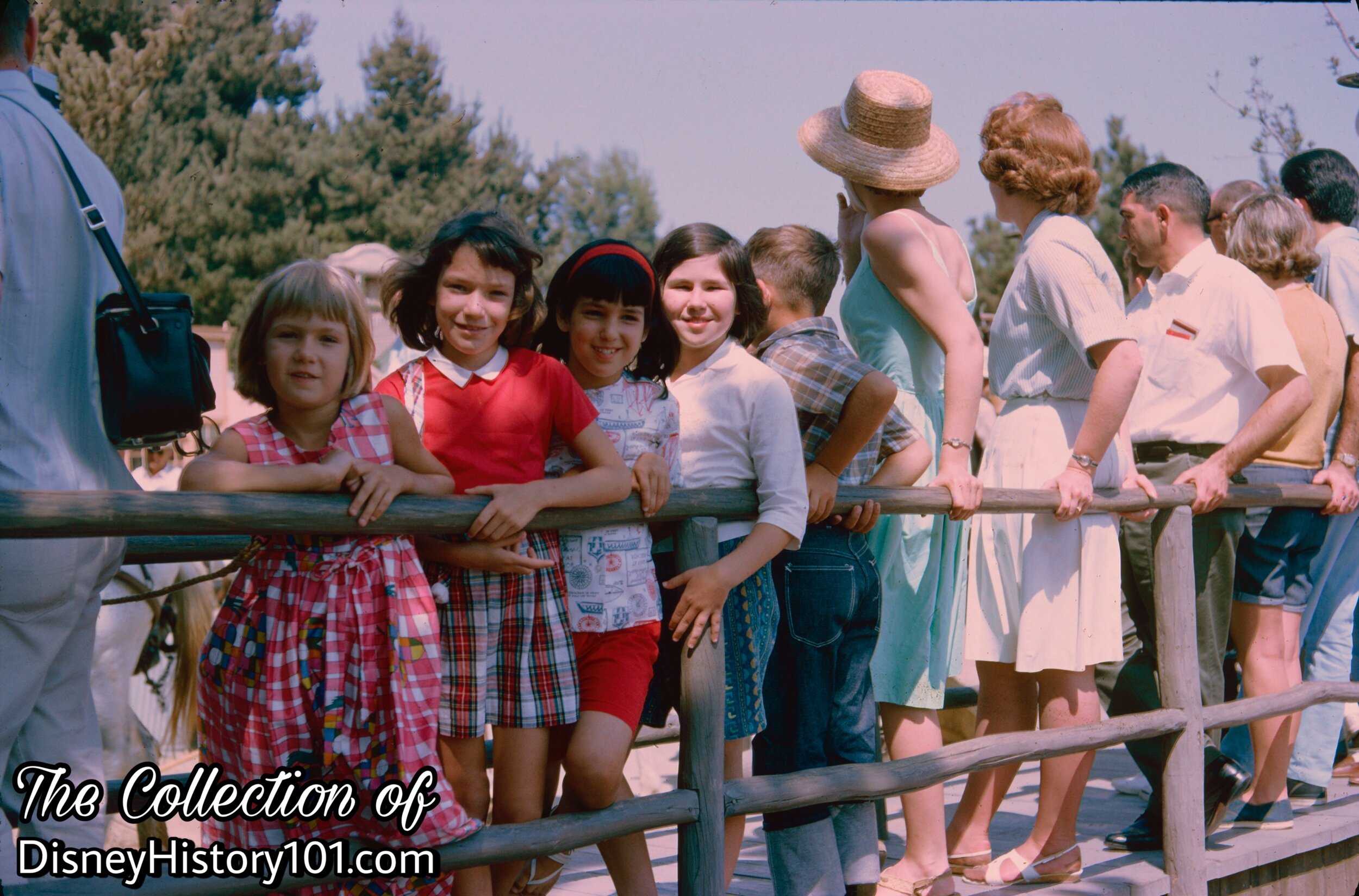
Younger guests also had the opportunity to mount their very own Pack Mules Through Nature’s Wonderland!
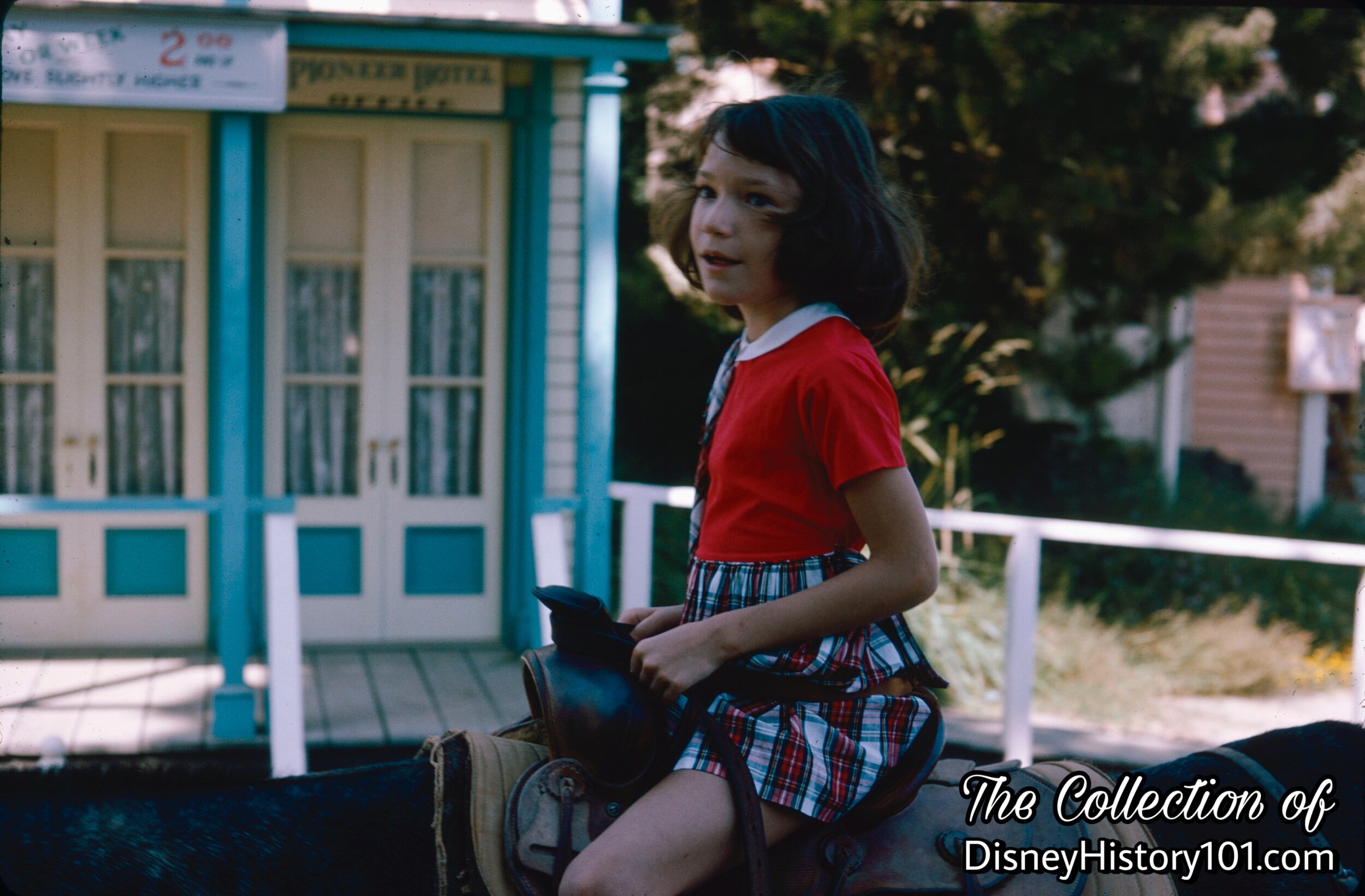
How exciting to not be required the accompaniment of an adult during the duration of your journey!
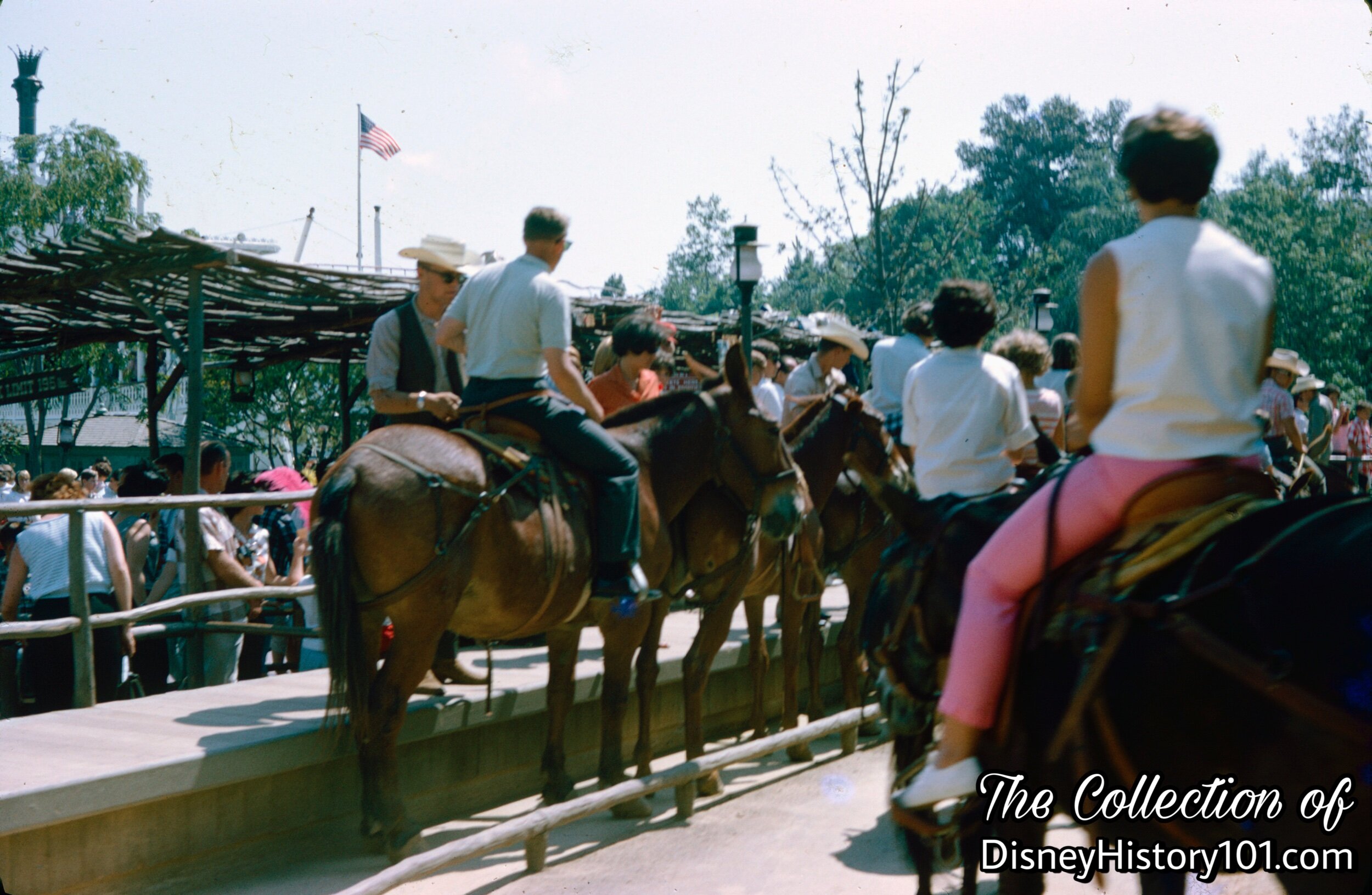

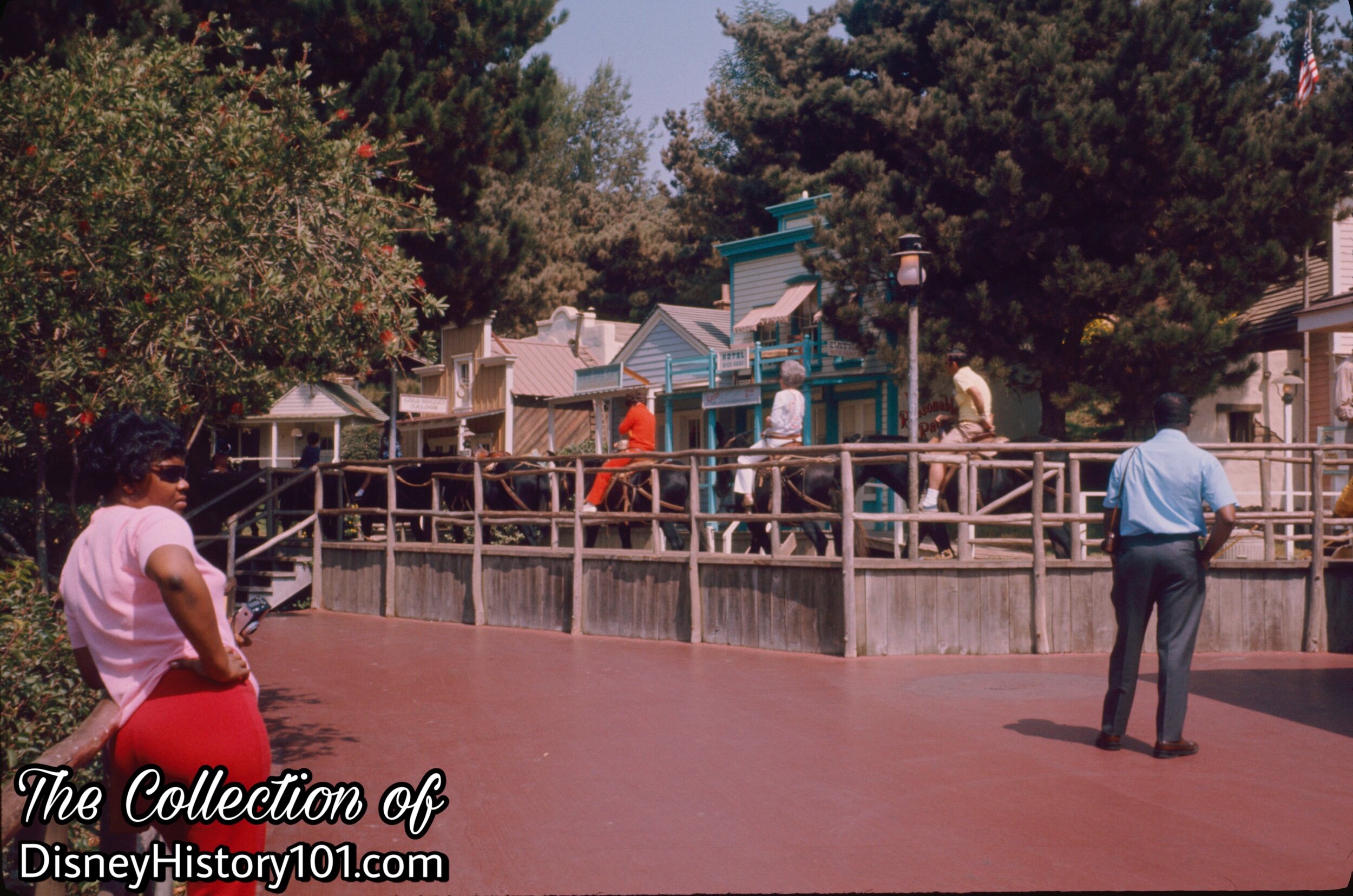

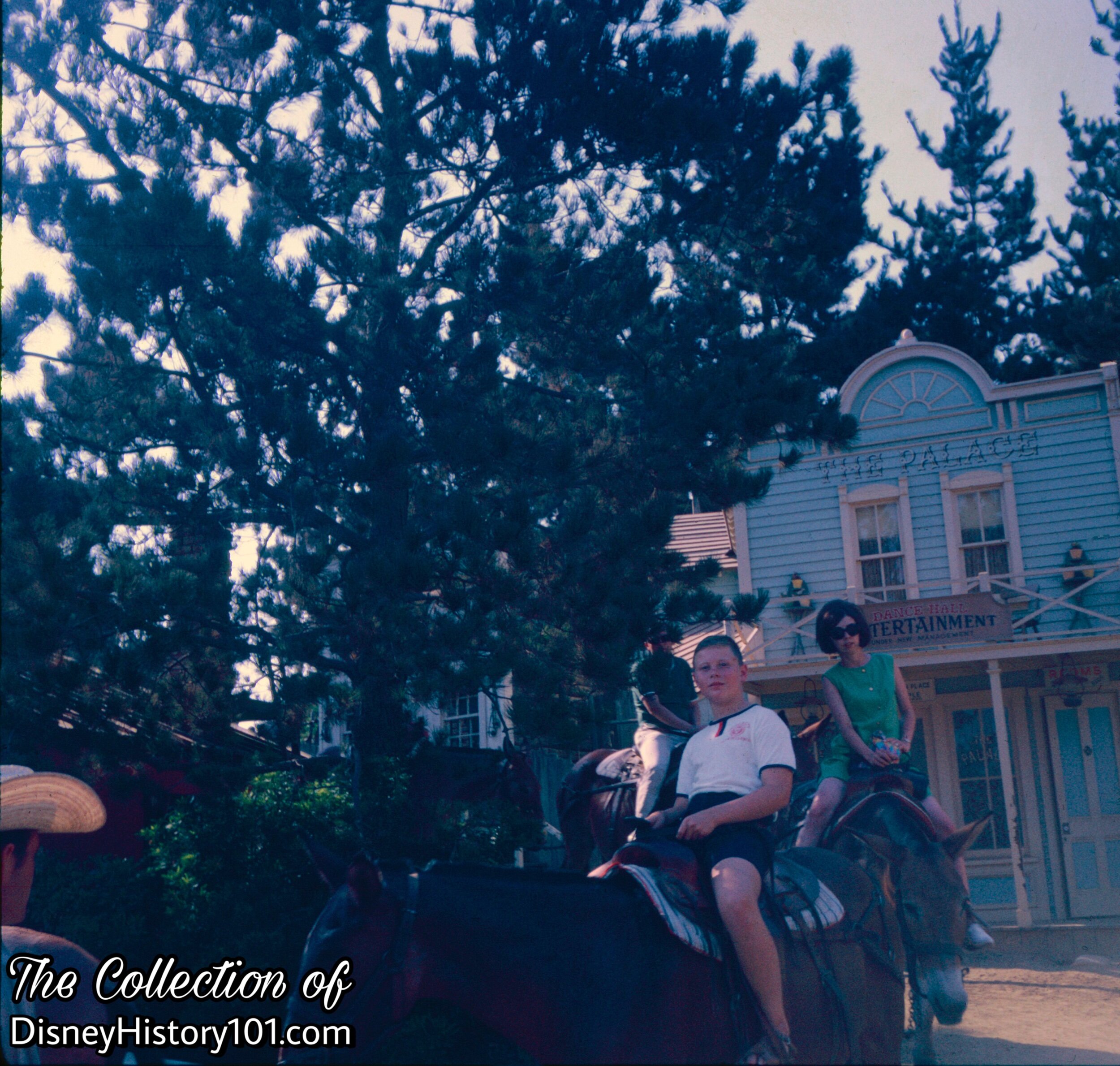
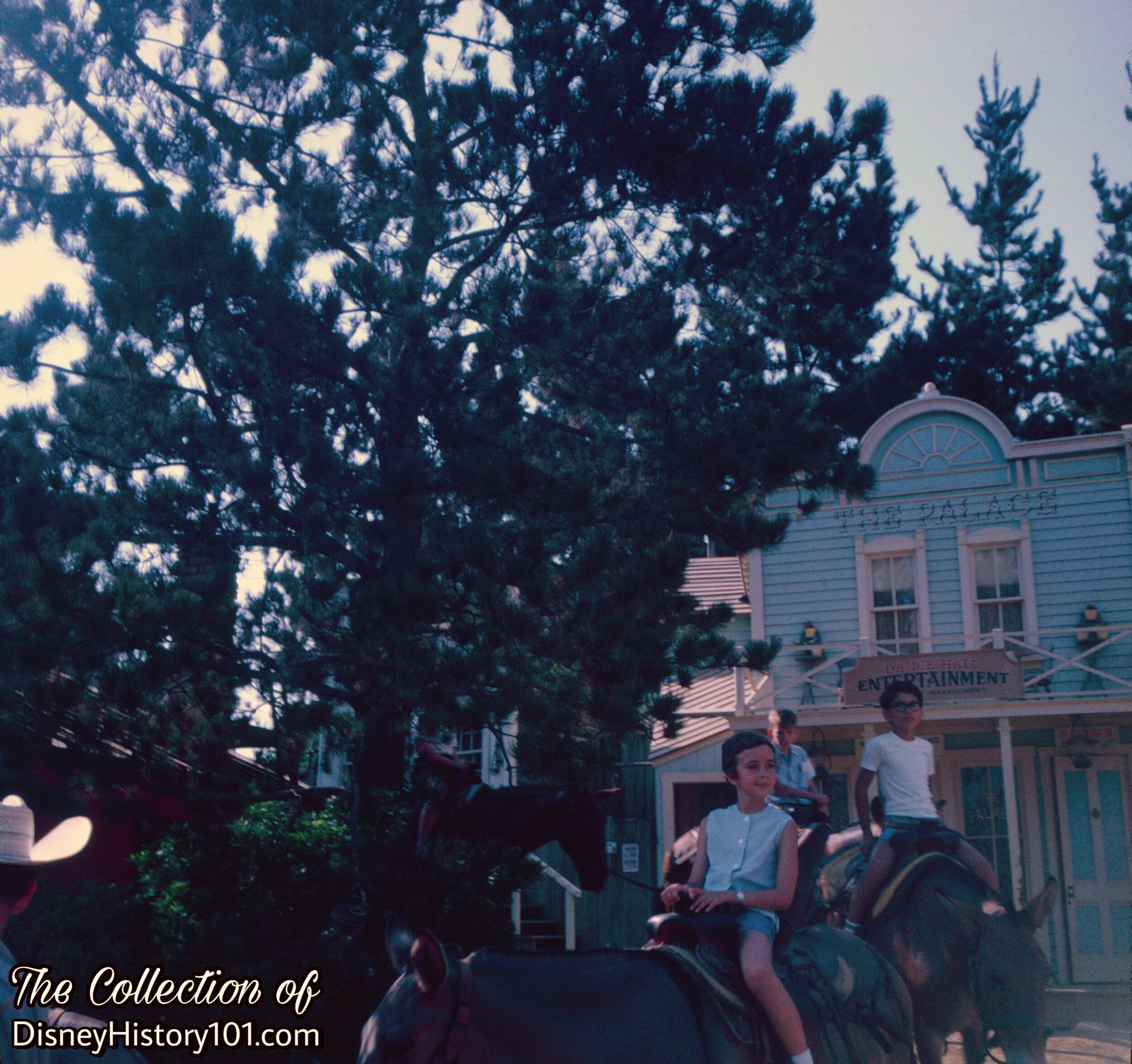
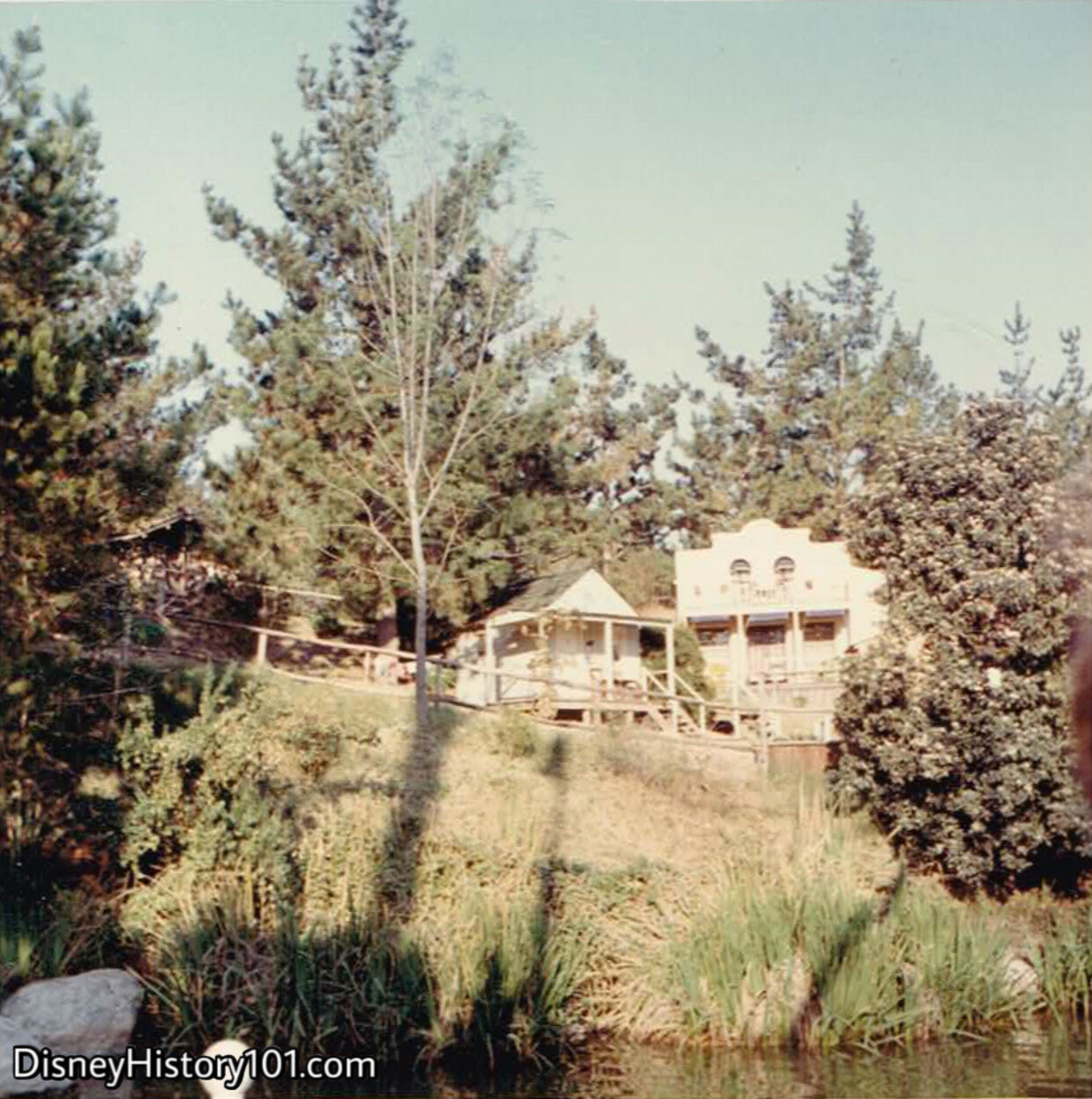
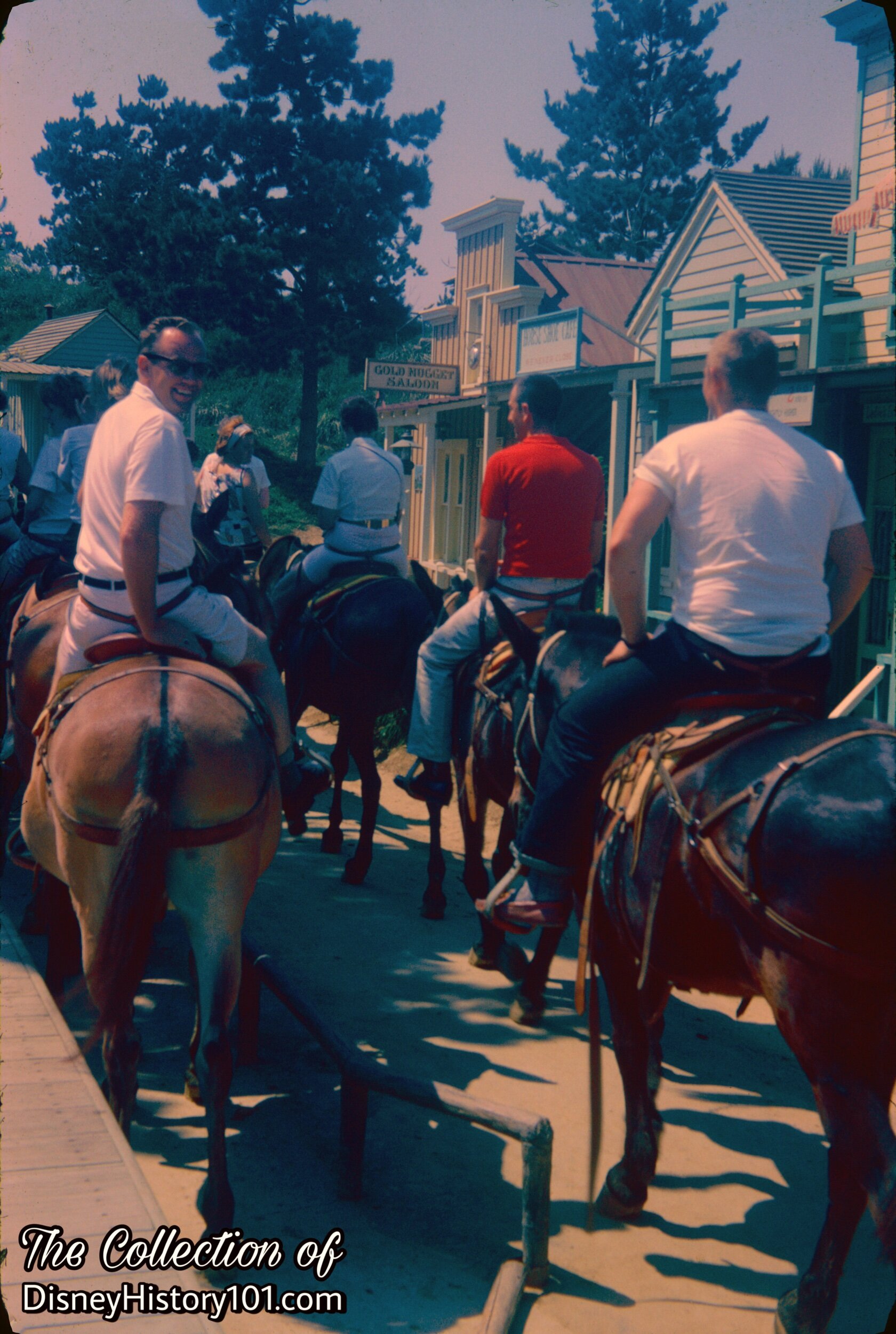
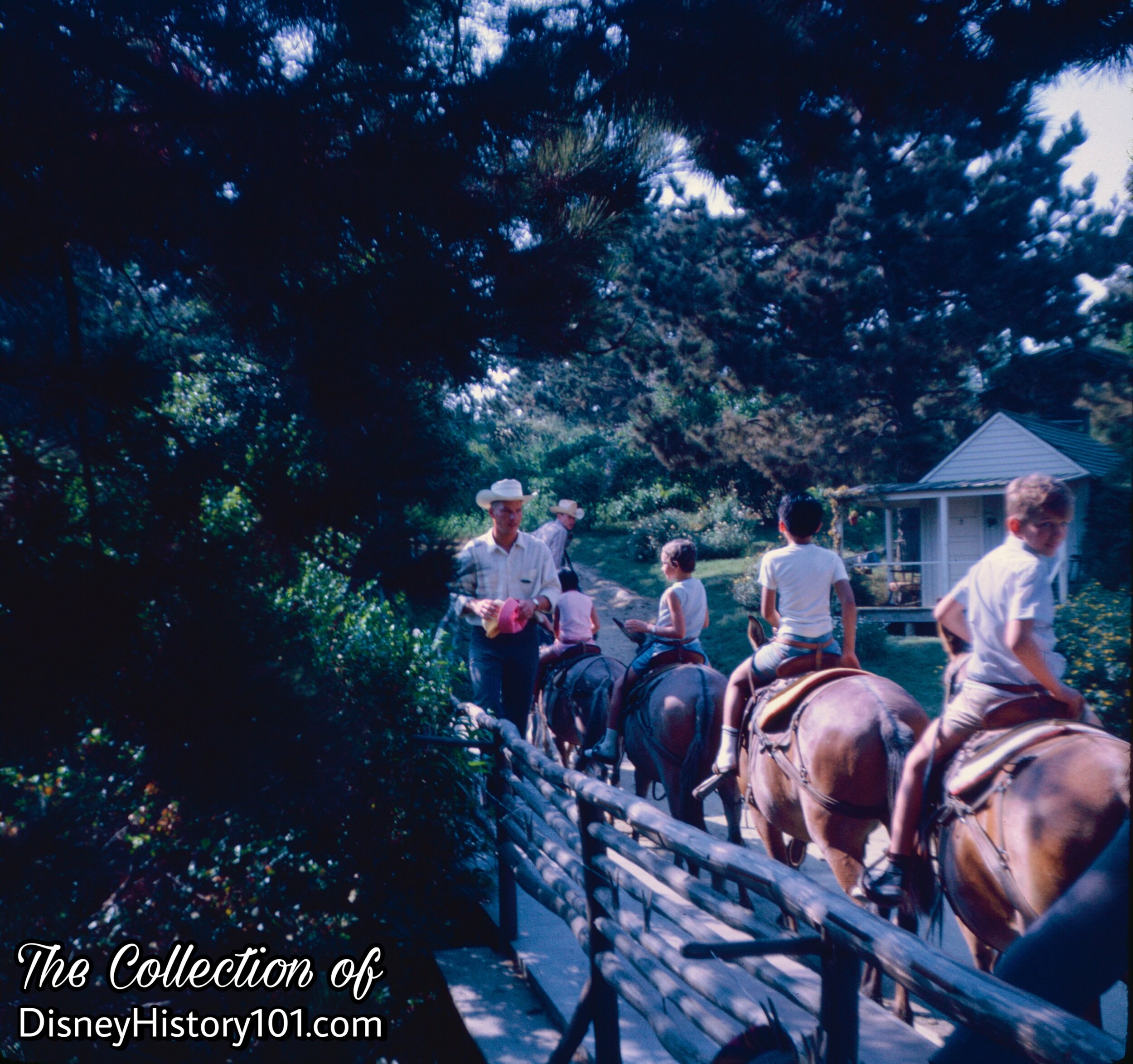
As we head across the bridge, and near the outskirts of Rainbow Ridge (c. July, 1967), we come to a small house perhaps owned by the proprietor of the Rainbow Ridge Hotel. We’ll be heading up into the hills now, so hold tight!
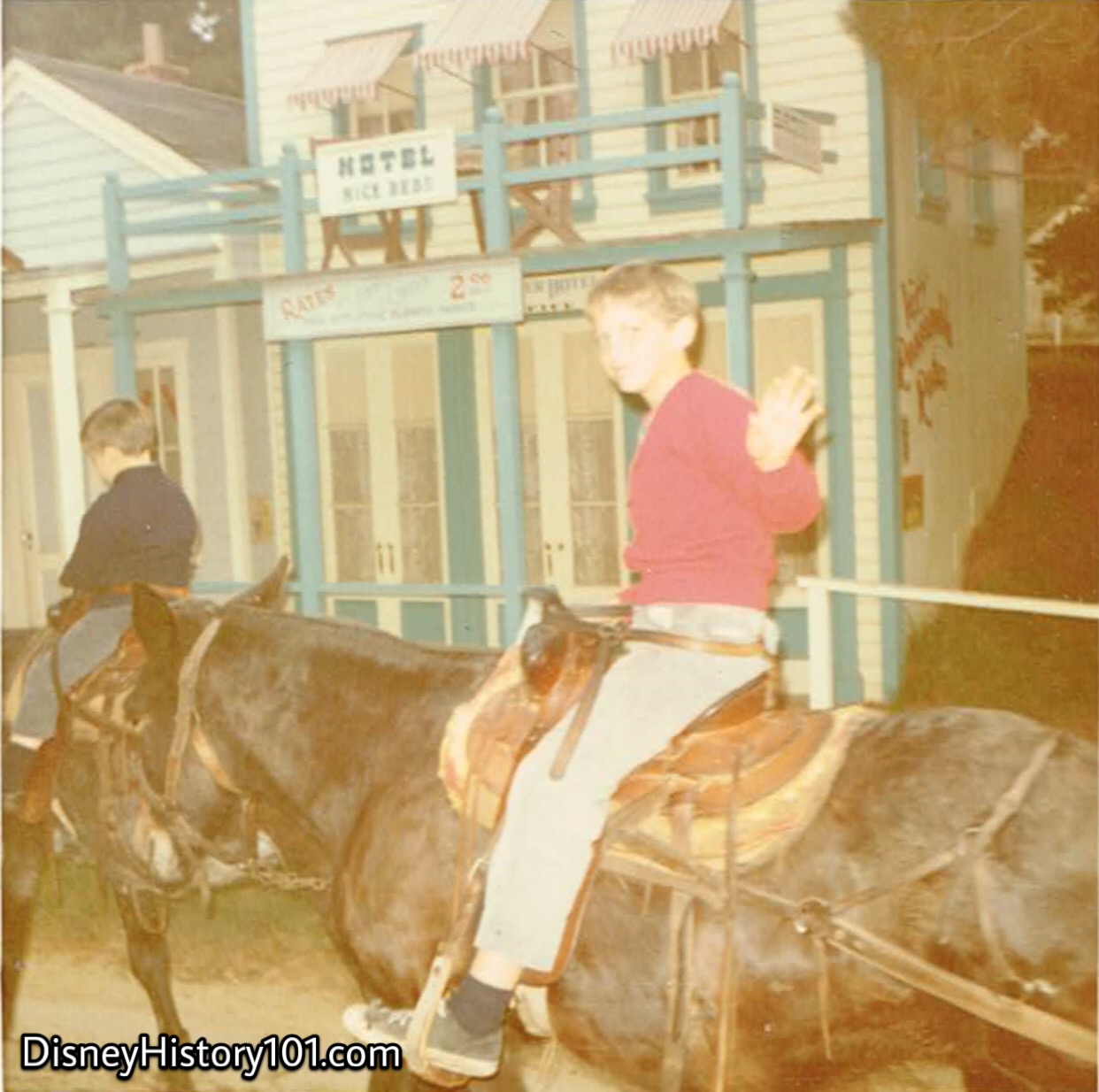
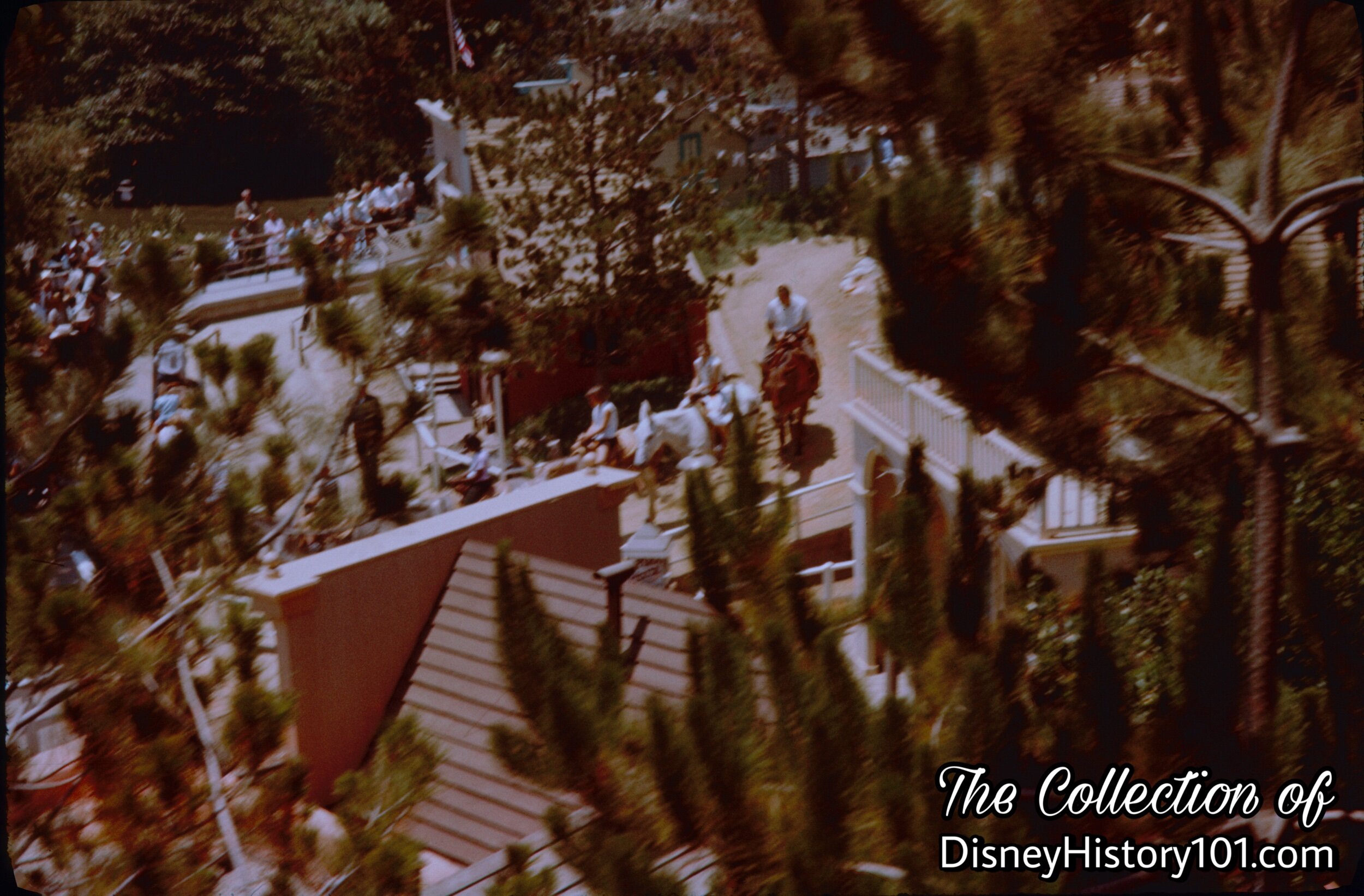
The Pack Mules also gave an alternate view of the town of Rainbow Ridge, because their arrival and departure wound the train into the hills.

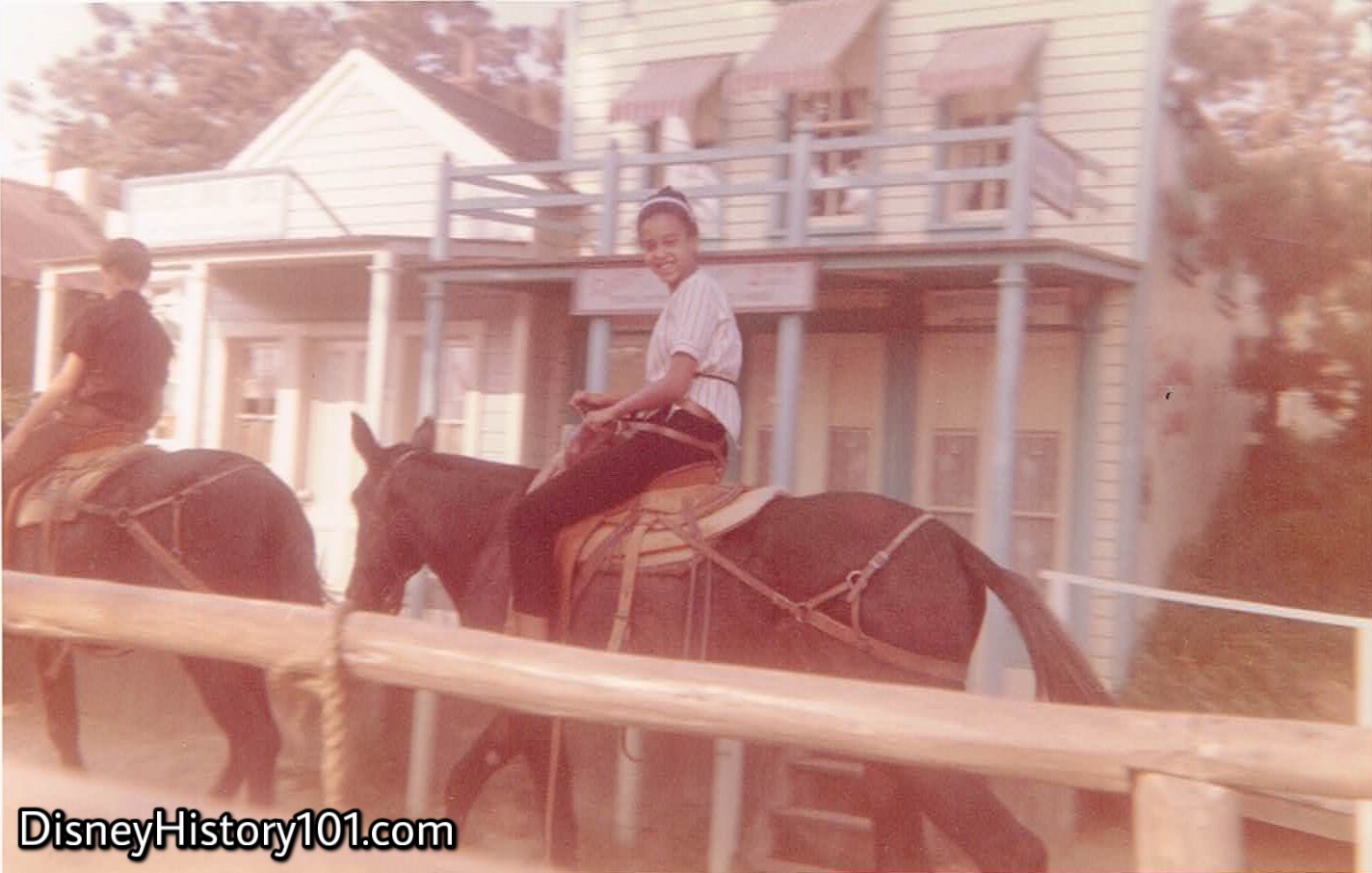
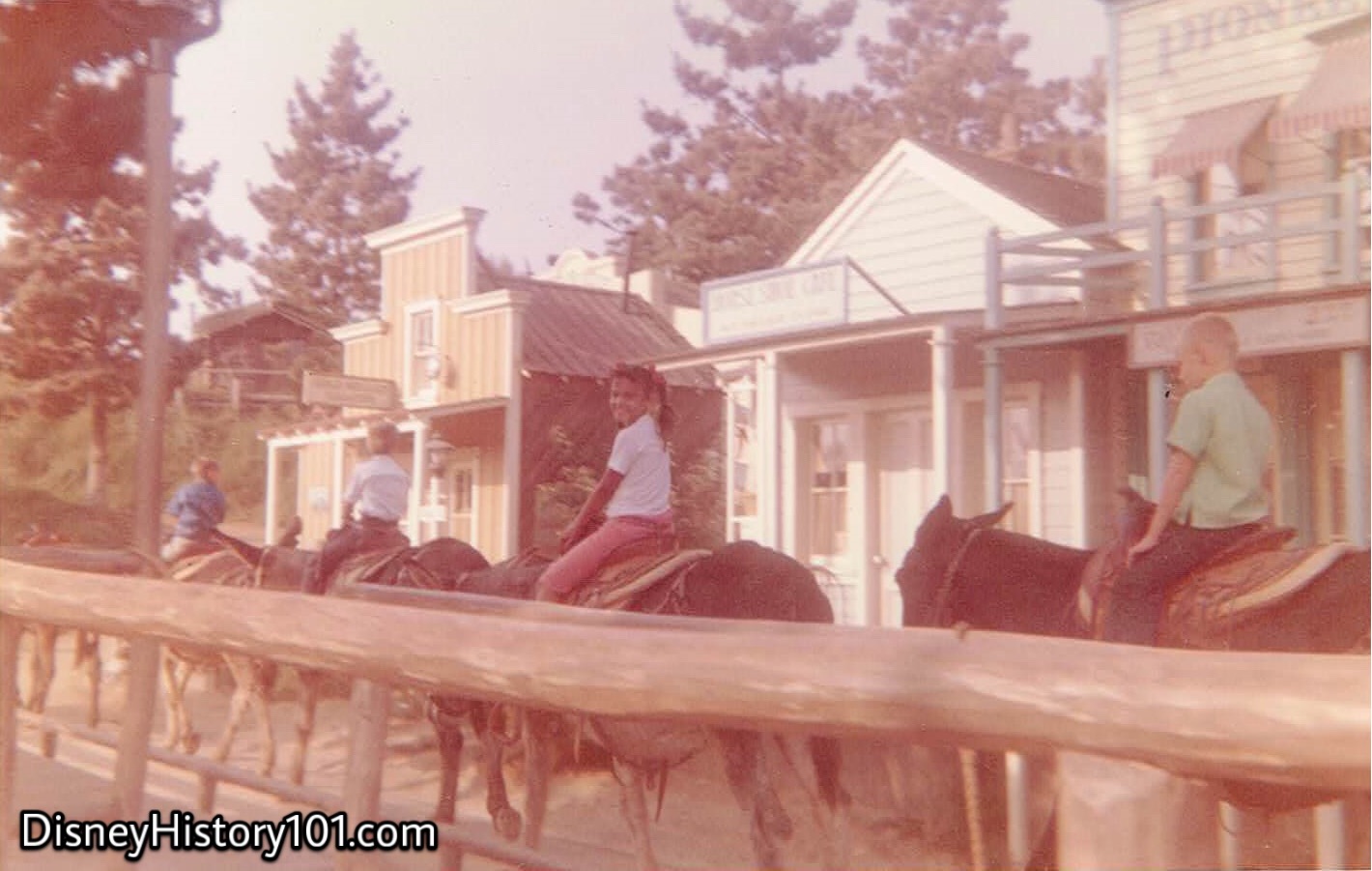
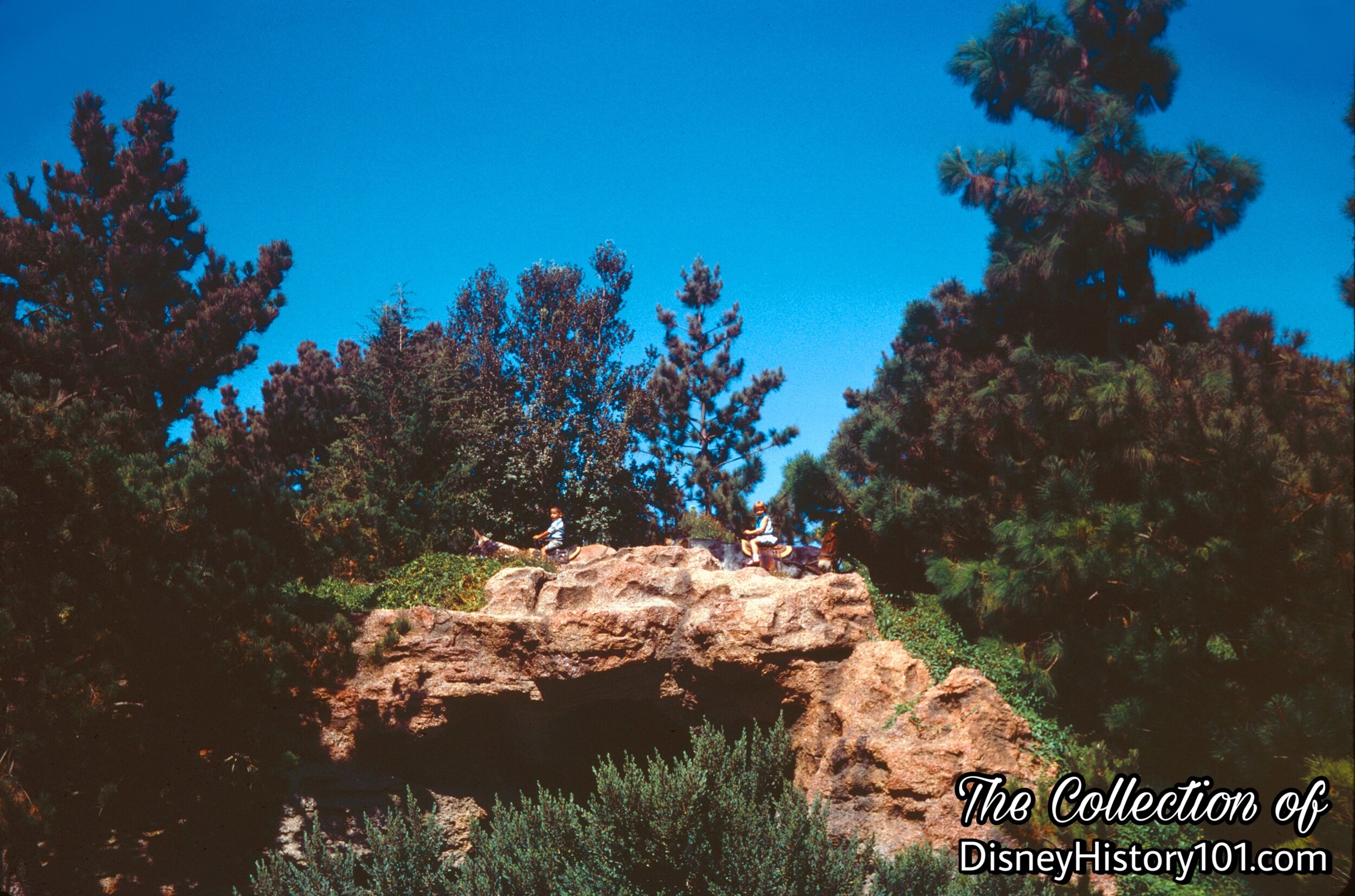
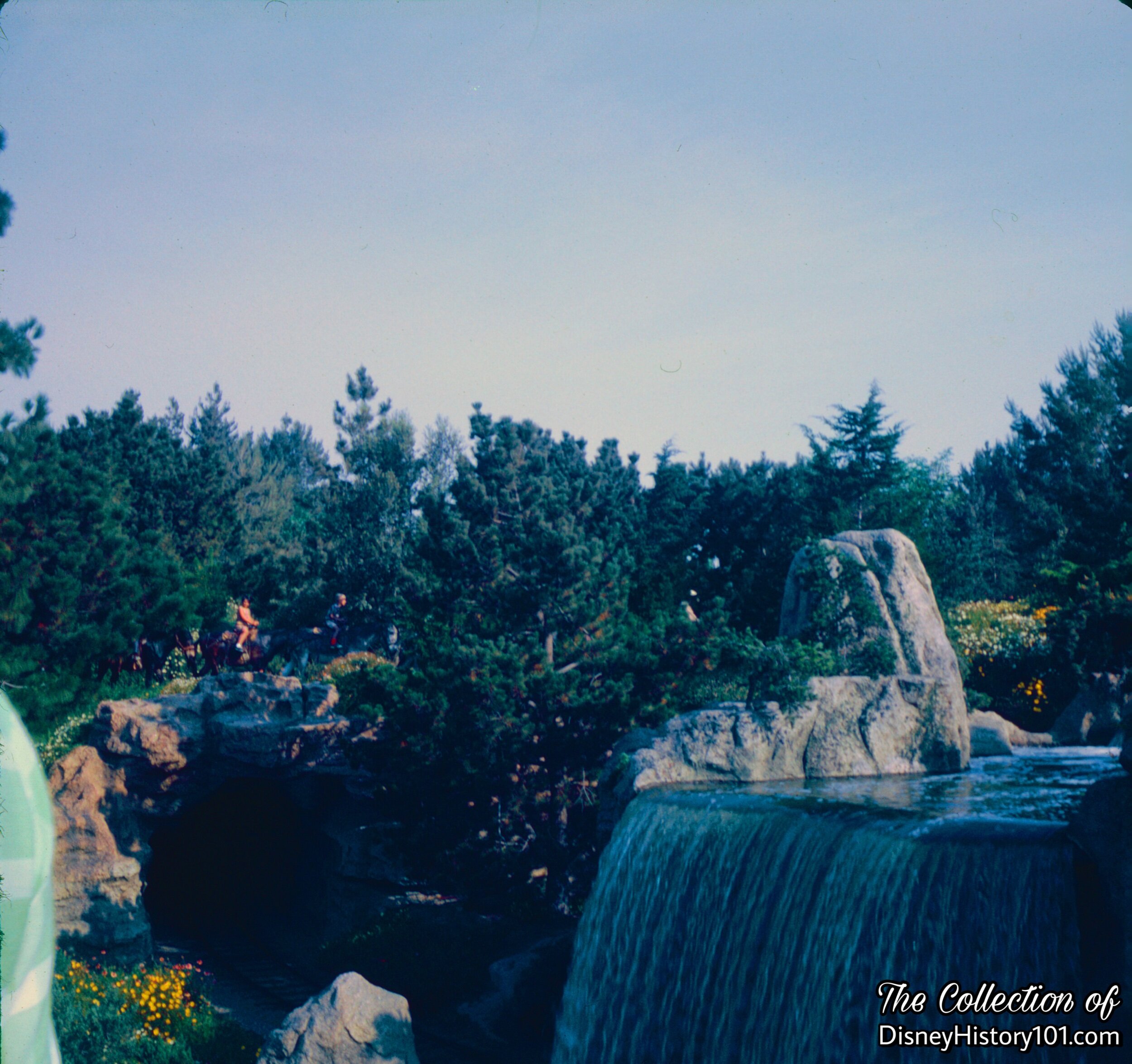
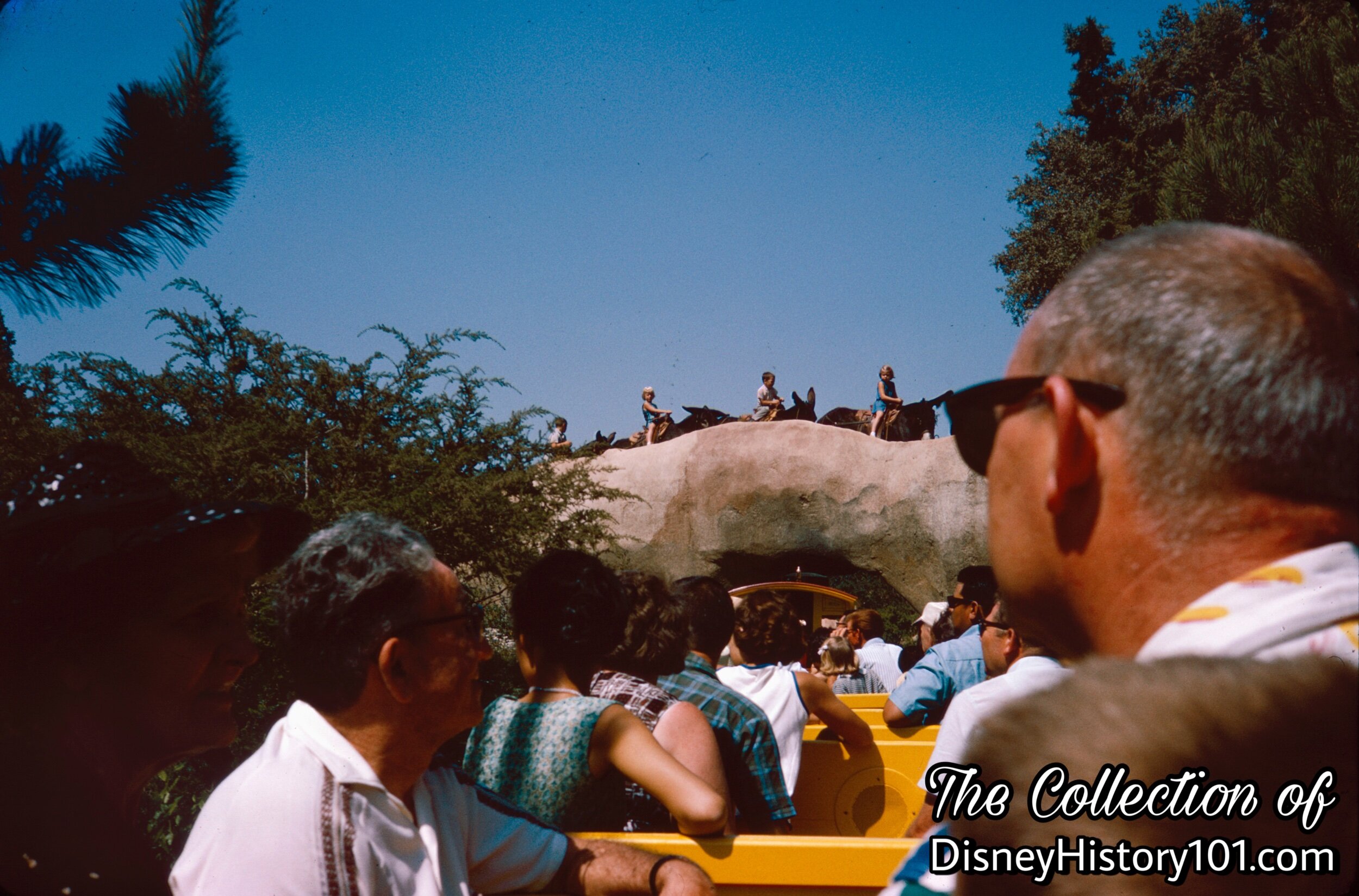
The Pack Mules Through Nature’s Wonderland would head over Natural Stone Arch (the gateway into Nature’s Wonderland) while Mine Trains would pass beneath. Natural Stone Arch gave a breathtaking view of the Bear River on one side, and the Living Desert on the other.
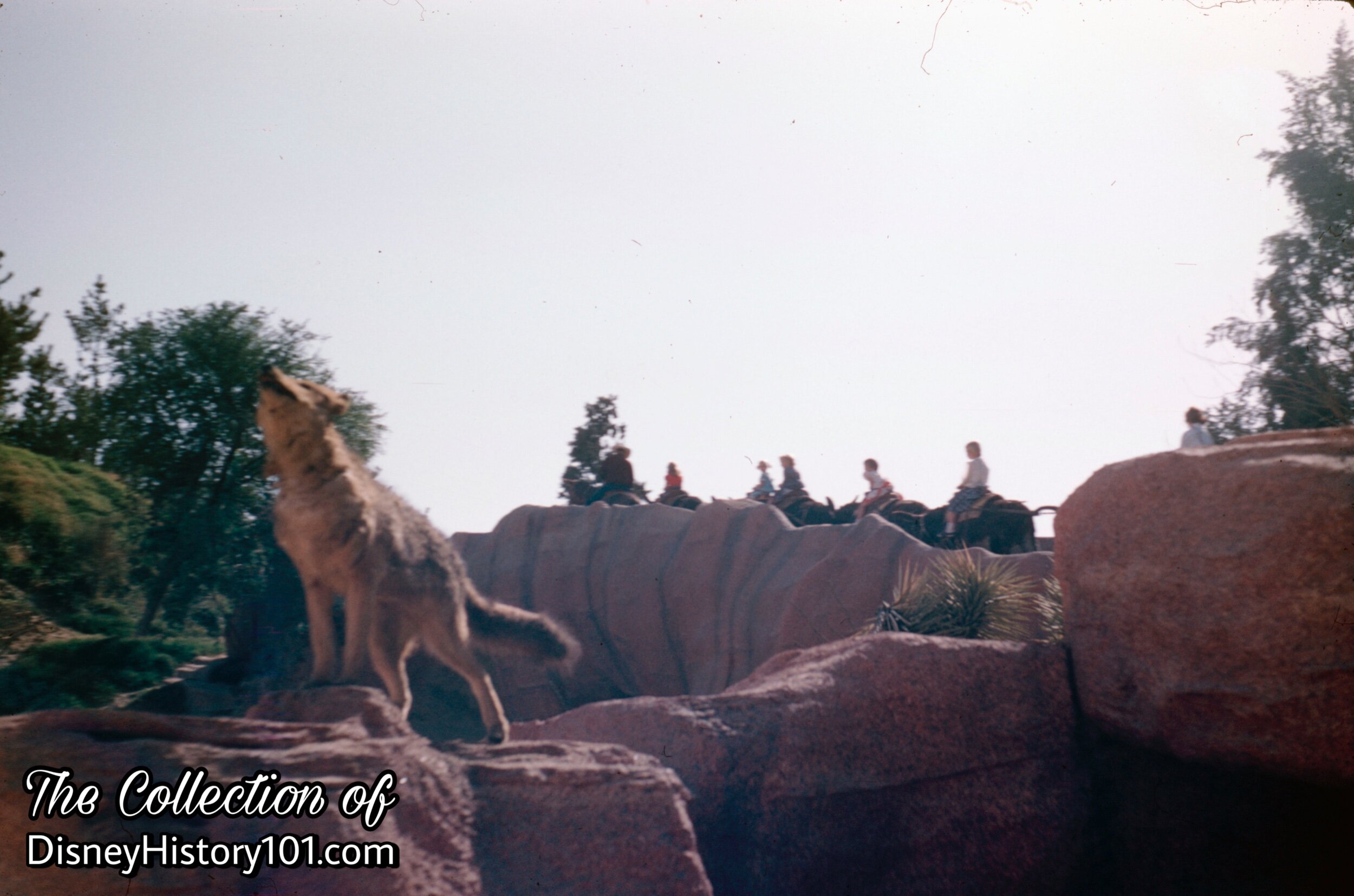

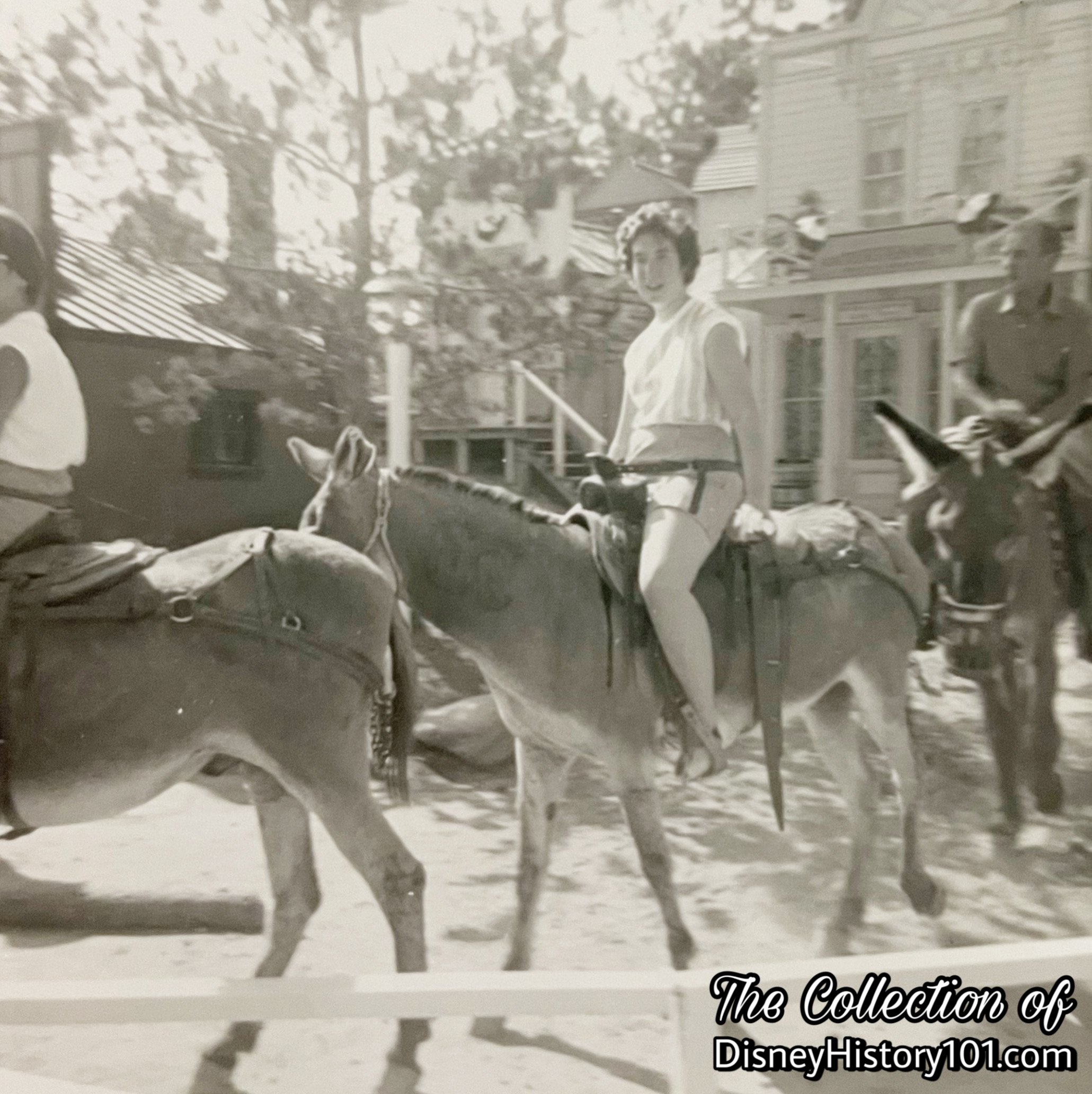
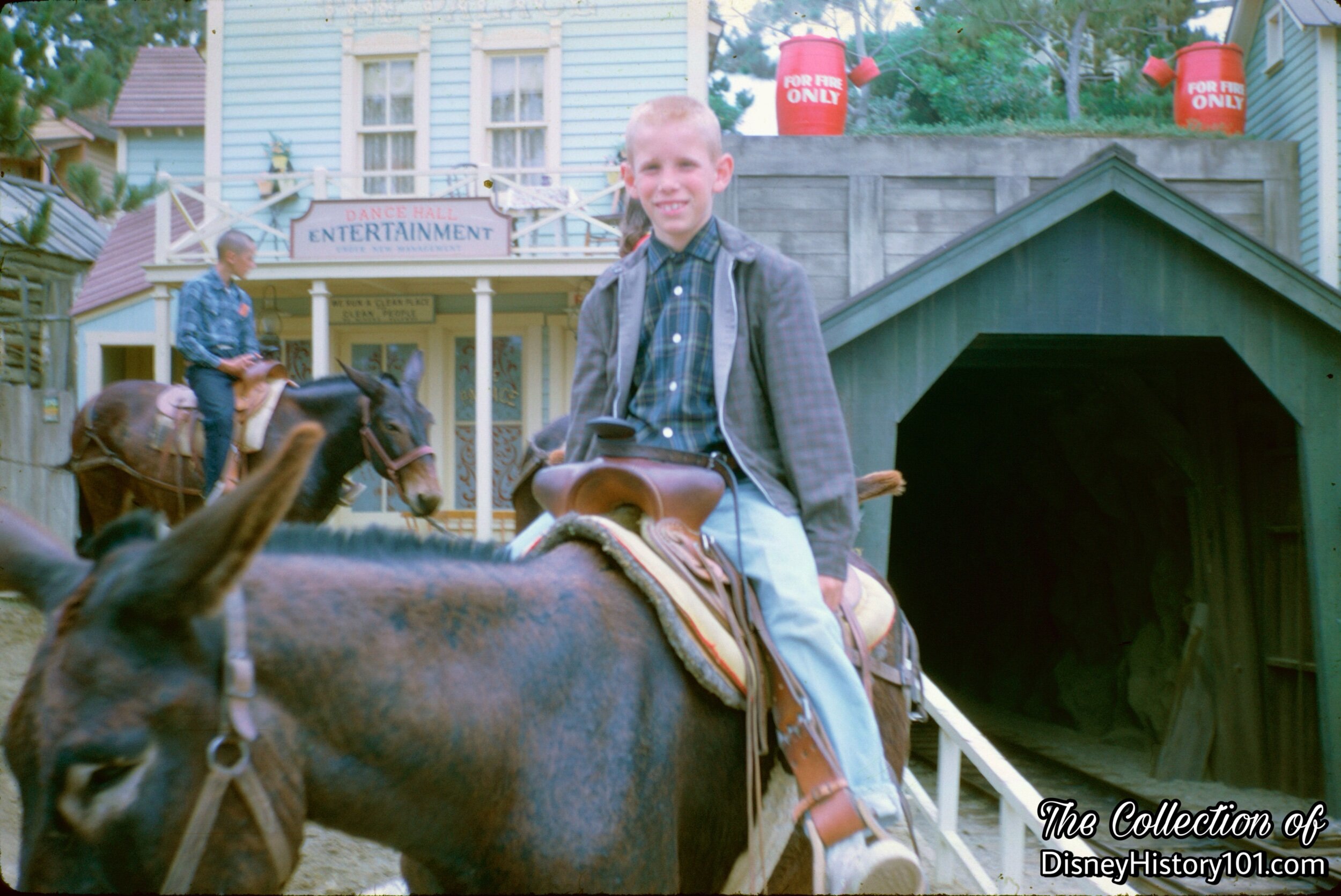
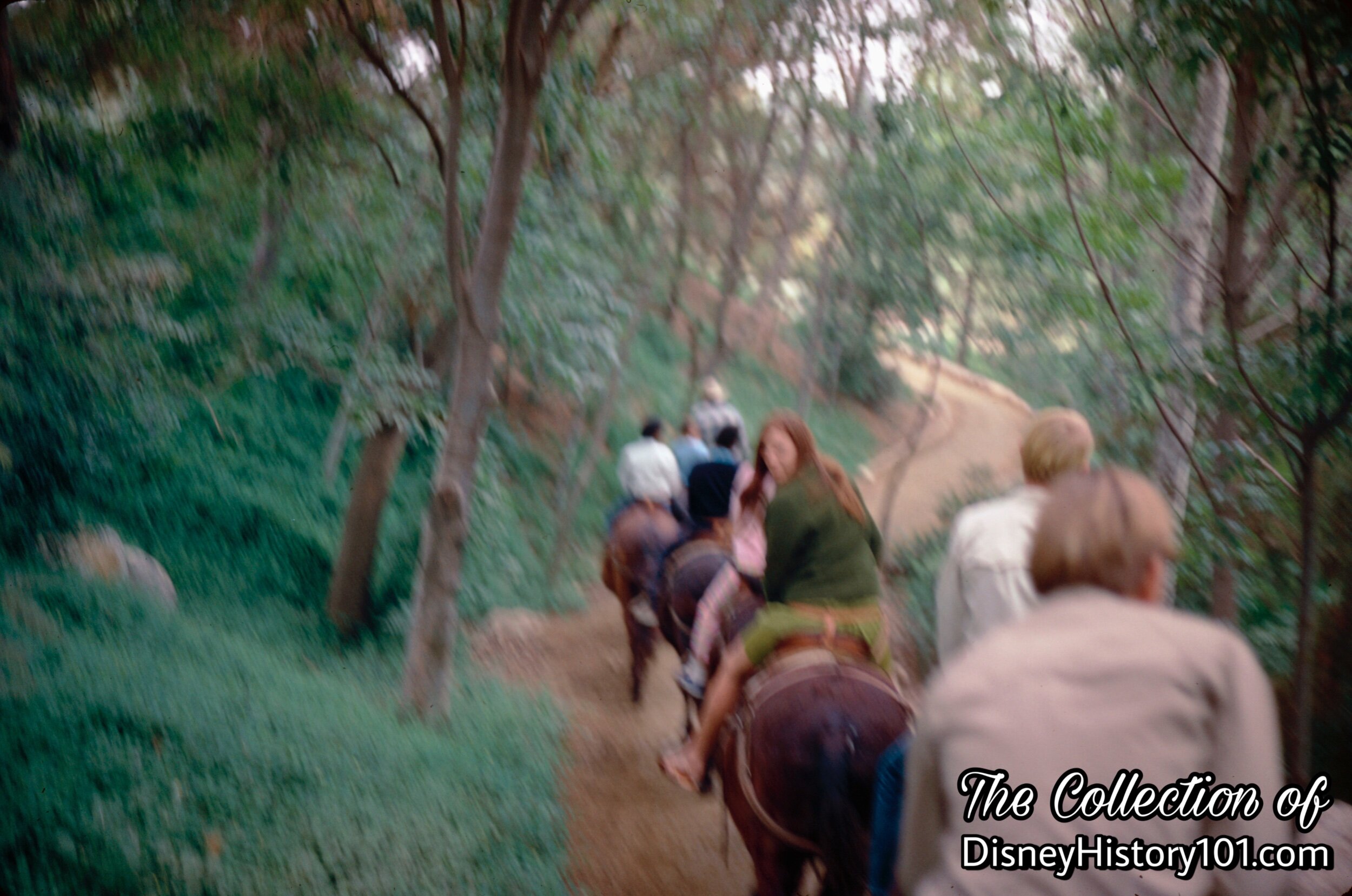

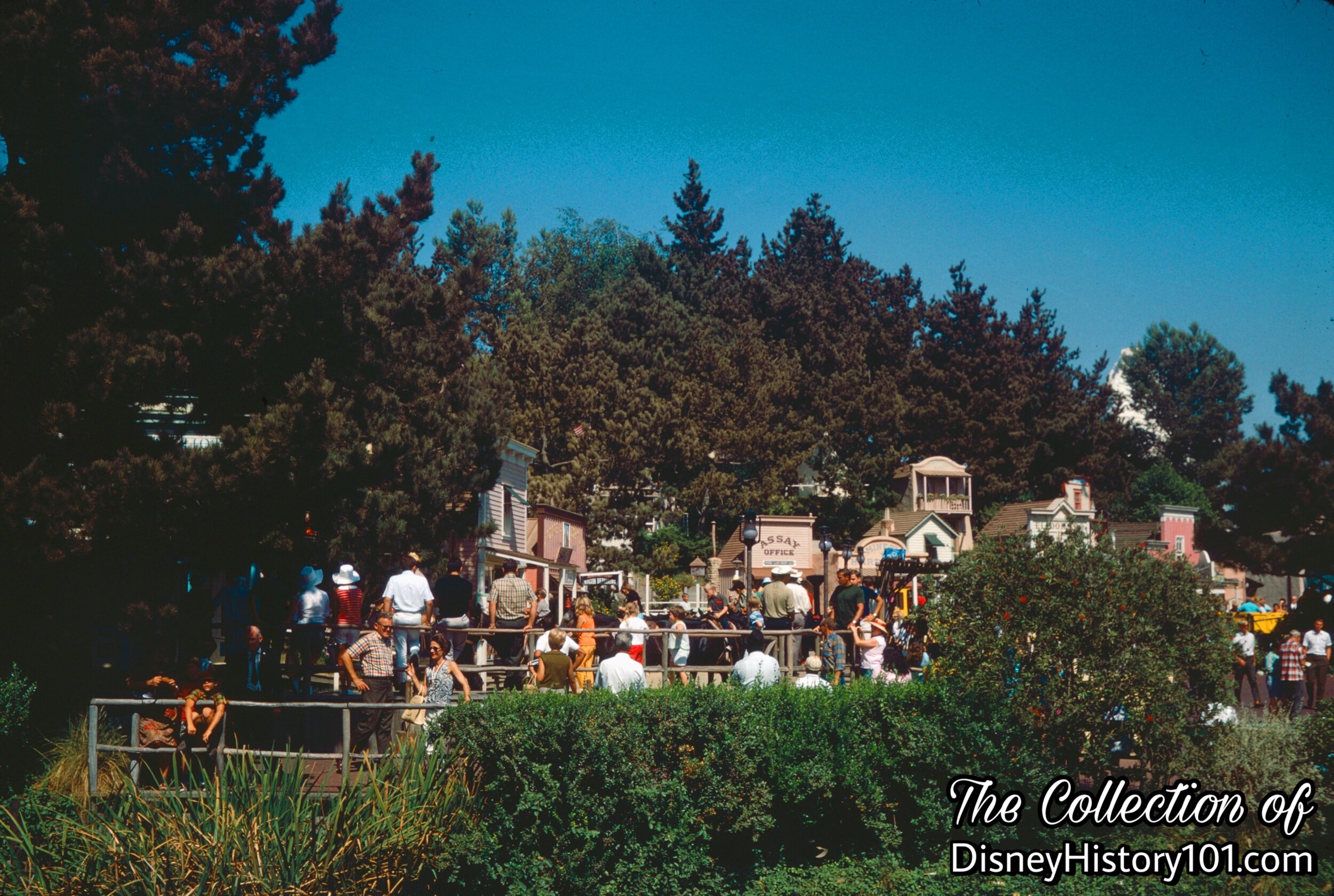
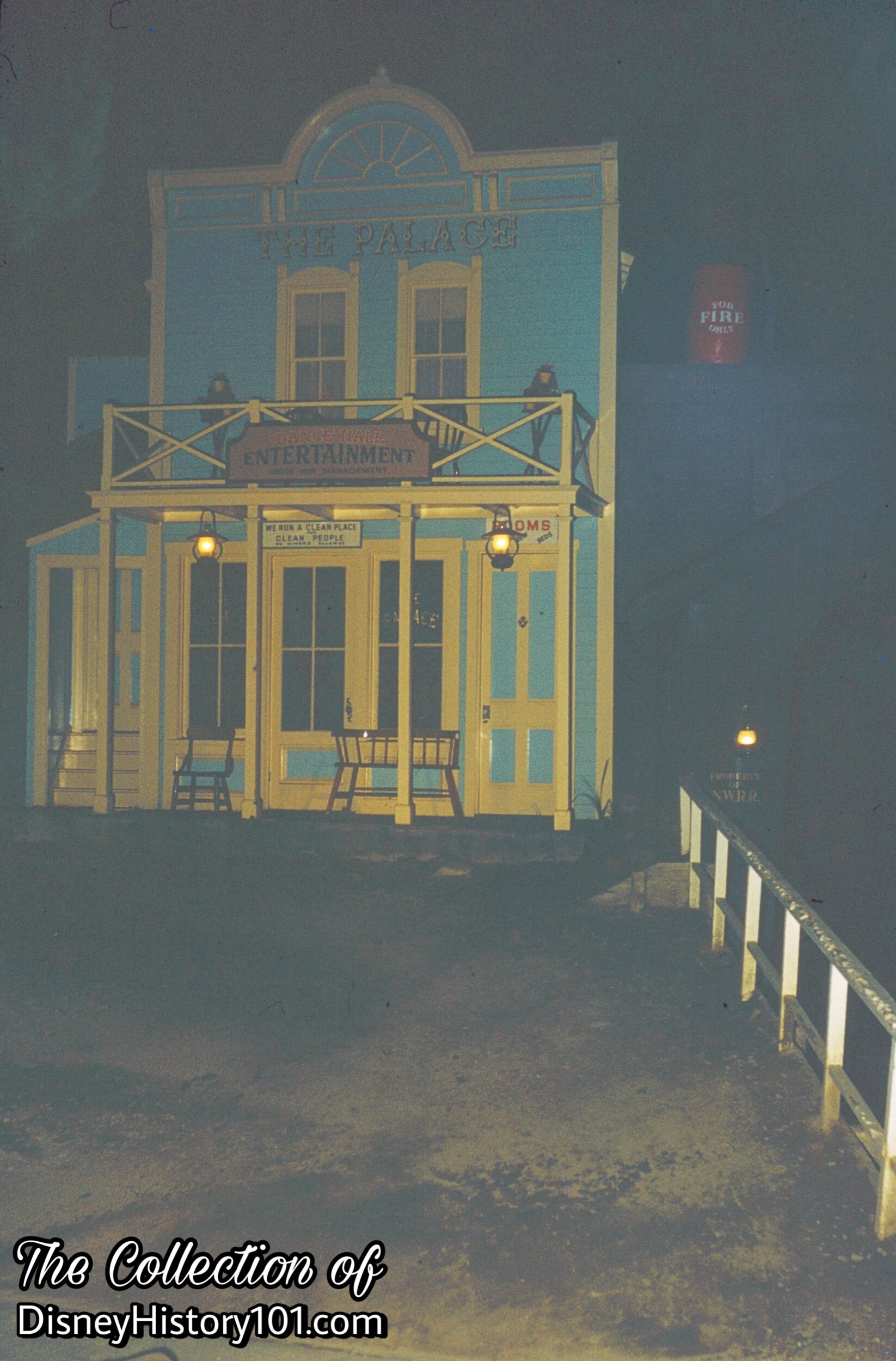
To the side of the Pack Mule trail, we pass The Palace Dance Hall at Rainbow Ridge.


Just about a stone’s throw from the Mule Loading Area, the neighboring Rainbow Ridge Mineral Hall carried many Mule-themed souvenir gems, like this Pack Mule Ceramic.

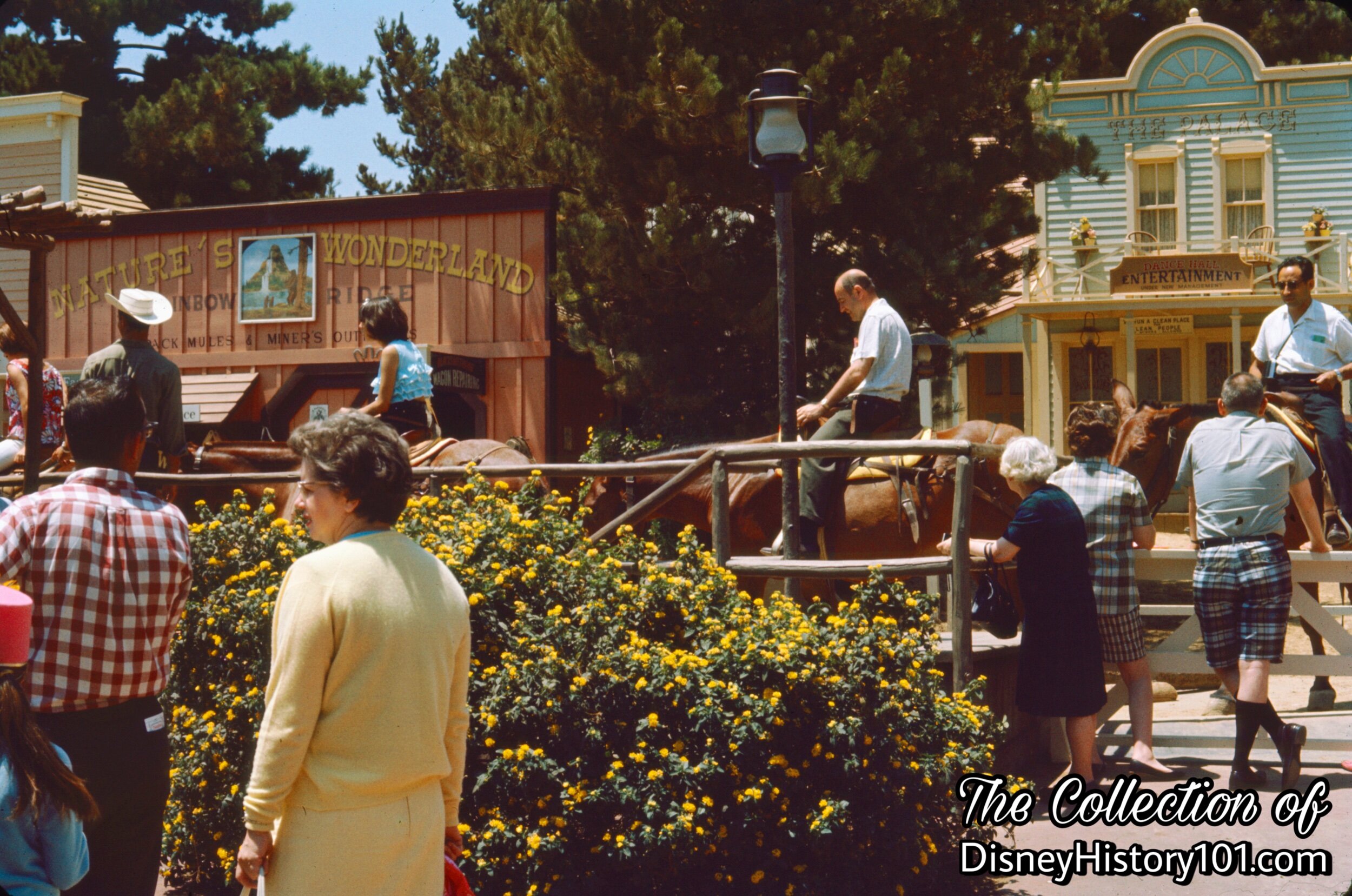
Safety is a major concern of Engineering. Every year they would make a complete test and inspection of all structural parts of Disneyland. And since Guests would look to Disneyland for their safety the department team was continuously designing new guest and personnel safety devices.
If an attraction at the Park proves to be dangerous, the problem is corrected or the attraction is eliminated. One casualty to safety was the Mule Train Ride. The Mule Train was responsible for the Park’s largest damage payouts, with at least four or five cases, major losses for Disneyland. Milo Rainey recalled: "Sometimes runaways would be caused by ducks flying across the river.” In the early 1970s, a man who fell off a donkey won a $146,000 verdict the largest single damage payout in the Park’s legal history. A Berkeley fashion model won $58,000 after she fell from a donkey and was stepped on, leaving a horseshoe shaped scar on her bank. As a result, the Mule Train would close.
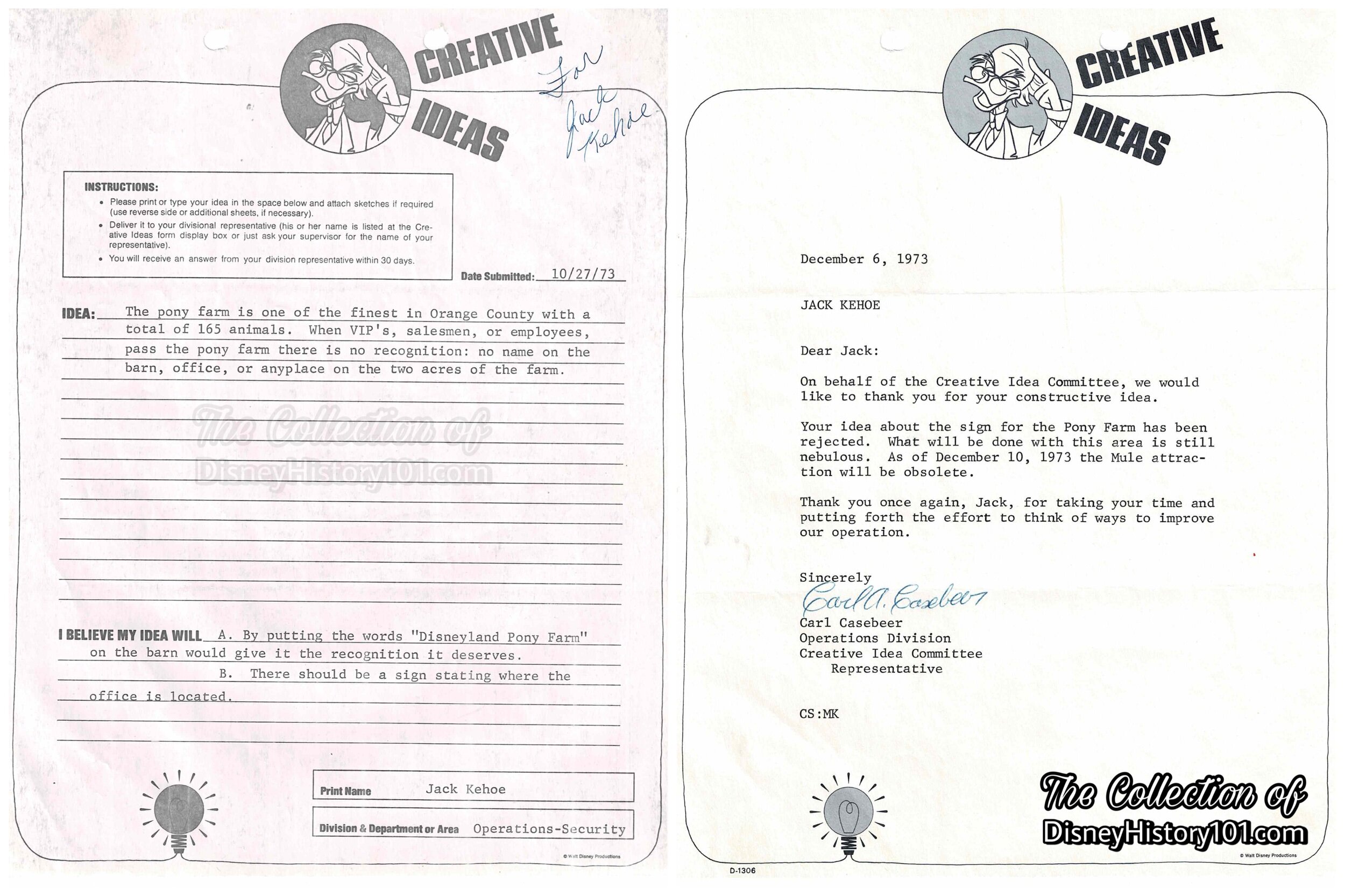
Jack Kehoe (Operations, Security) suggested that the “Pony Farm” receive a sign labeled “The Disneyland Pony Farm,” but the official response would have been hard for some to handle. Though included in the Disneyland Admission Media Ride and Attractions Report of 1971, it seems that the “Pack Mules” was nearing the end of the trail. By February of 1973, the last pack mule had walked through Nature’s Wonderland.
While most of the mules would disappear from Frontierland (and Disneyland), the old Pony Farm wasn’t going anywhere (at least, for a while). And Jack was sure on to something. Seven years later (in 1980), another Disneyland Cast Member (Main Gate Ticket Seller Sandy Oleson) helped give the Pony Farm a new name - Circle D Ranch!
As a “sidelight,” another equestrian relic from the past - “the original trail for the Pack Mule attraction (1957-1978)” was still extant in the hills of Frontierland by 1990, according to “Disneyland - A Treasure Chest of Trivia,” prepared by Walt Disney Productions, 1990.
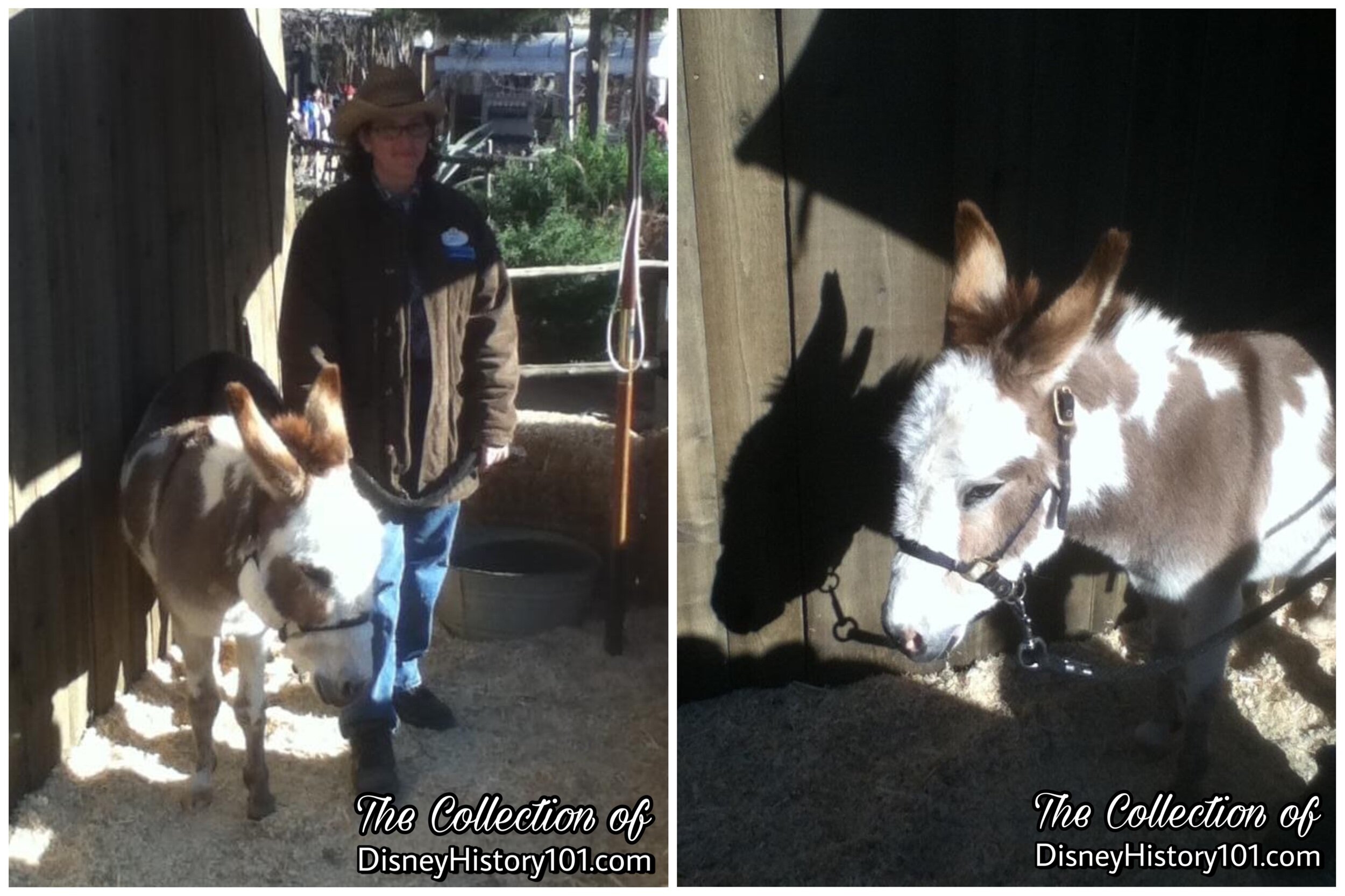
Not far from the “Big Thunder Mining Operation,” the “Happiest Horses on Earth” exhibit brought a familiar face On Stage - a mule!
OMNIBUS


At Disneyland there is a "story behind the story" of every attraction, every attraction is a living experience for the guest. Disneyland ride-through attractions or adventures have officially been defined as an “individual show, ride, or exhibit designed to produce an entertaining Guest experience. Disney attractions stir the imagination, enliven the senses, and provide the participants with positive, innovative entertainment, which is the essence of the DISNEYLAND Show.” It is important to review the story of the attraction, tell the story, explain it, and create interest. This is the story of the Omnibus.
“Walt was reared in the mid-western town of Marceline, Missouri. As with other lands, he wanted Main Street to be a Main Street - authentically recreated to get the feel of a typical small town thoroughfare of the 1900 era with which he was familiar.”
Take a close look at Main Street. “Note the results of years of research to determine and design a composite Main Street of the typical small town of the early century. Note the demanding attention to detail designed and built into every nook and cranny by Walt and his ‘Imagineers’ at WED Enterprises. This same demand for detail is designed into Main Street vehicles.”
Please watch your step aboard the 5/8 scale open-air, 13’ 3” - high, double-decked Omnibus that recalls the days of old in-city transportation while giving guests a view of the sights from the heights.
I would like to begin our Omnibus story with an interesting sidelight. I would like to recall one of the first times this method of “old in-city transportation” was referenced in a work of Walt’s, it was in Alice's Brown Derby. You may be surprised to hear that the first time the words “Disneyland Omnibus” appeared in print, it was two decades later, on the cover of a c. 1945 Walt Disney Mickey Mouse, Ltd. licensed hardcover book published by Collins Publishers (of London and Glasgow). The illustration on the cover even featured Mickey Mouse at the wheel of a double-decker bus with the words “To Disneyland” over the drivers’ section of the cab. This depiction was astoundingly made more than a decade before the Disneyland Omnibus became a reality.
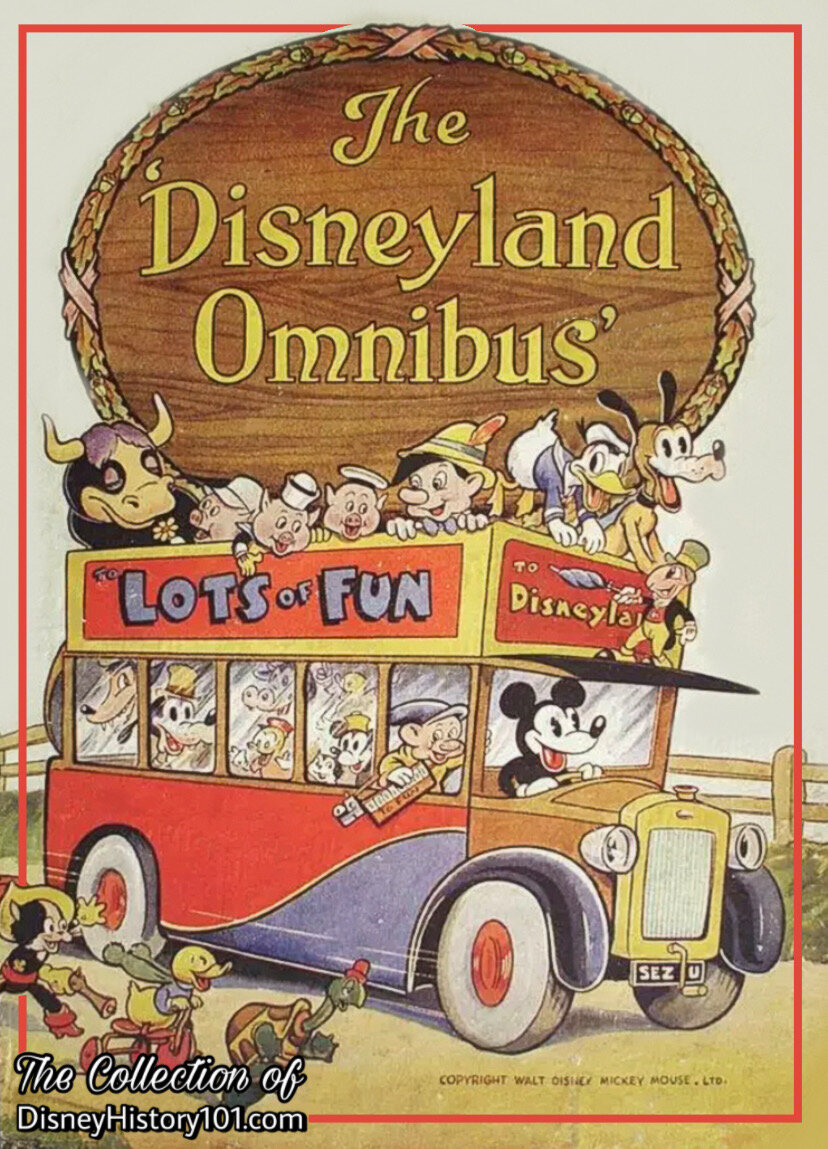
“Construction of Disneyland’s Largest ‘Horseless Carriages’”
As the Omnibus was reckoned a type of Horseless Carriage (and of WED, Enterprises’ design), it shared many similarities with some of Main Street’s other vehicles. According to “Main Street Vehicles”, published 1966 by Disney University, “The Horseless Carriages are sometimes called the ‘1903’s’, but you could pick any year - 1904, ‘05, or ‘06, and be just as accurate. These little cars are of WED ‘composite’ design. On the basis of extensive research, Studio designers created a horseless carriage which was a composite of the design and size of many gas-driven cars of that early period in automobile history. And our Horseless Carriages are a little bit of everything.” Some of these very things ring true with the Omnibus.
The Omnibuses were built at the Walt Disney Studios, under the direction of both Roger Broggie and Robert Gurr (though they were referred to as “Gurrmobiles” for perhaps the first time in “Walt Disney’s Magazine”, Vol. 2, No. 5 ; 1957). The gasoline-powered Omnibuses were “patterned after French and English buses of 1908,” and compared to those that one operated on 5th Avenue. Despite their outer appearances and yet these vehicles were unlike any old-city bus. For example, its drop frame chassis was taken from a modern truck. According to Vacationland (published Winter, 1958), “this was the only bus of its kind that ever had power brakes and power steering,” owning to its modern engine. “The two-cylinder engines are actually not auto engines, but have the horsepower, the sound - and even a slight case of the shakes - as did the originals. WED designers selected today’s most efficient two-cylinder water pump engine. Some of the external parts, such as lights are authentic… Certain adaptations in height and seating to provide greater comfort, safety, and convenience for our guests were made by Studio designers, but the busses are as nearly authentic as possible. The motor takes advantage of modern improvements which provide for better operation - and no smog,” [“Main Street Vehicles”, published 1966 by Disney University]. Lastly, the electric English Klaxon horn adds an authentic touch to the vehicle.
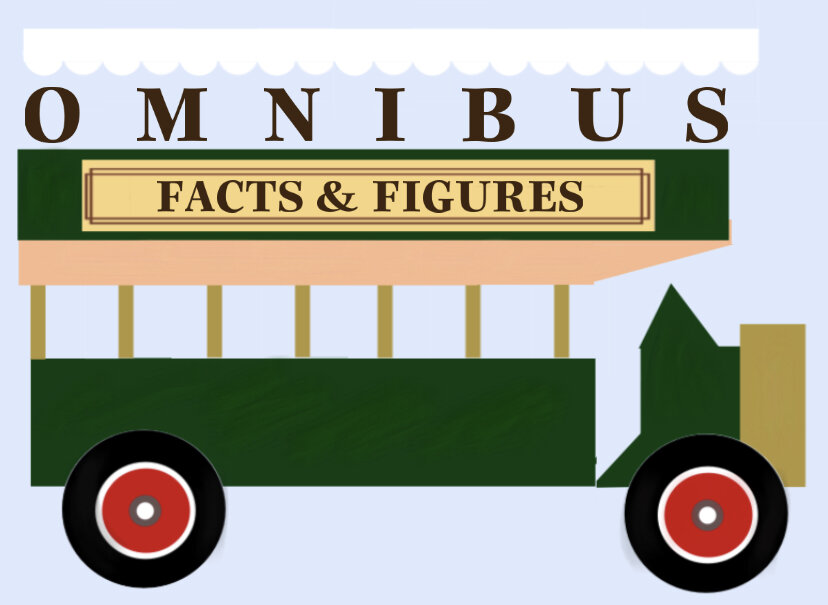
Make : International
Model : BD 264
Maximum Passenger Capacity : 37
Height : 13’ 3”
Length : 26’ 3”
Width : 7’ 6”
Weight : 8,250 Lbs.
Engine Numbers : 376257 (Omnibus 1) ; S160S121766 (Omnibus 2)
License Numbers : E26668 (Omnibus 1) ; J-64561 (Omnibus 2)

You may recall hearing how Walt Disney, on the eve of Disneyland’s first day of operation, promised that “Disneyland will never be completed. It will continue to grow, to add new things, as long as there is imagination left in the world.”
“Main Street vehicles play an important part in the Disneyland show. First, they are essential to the staging of Main Street, U.S.A. The contrast to the hustle and bustle of our modern world and its streamlined modes of transportation is sharp and penetrating. Suddenly, as a guest comes onto Main Street, the entire mood changes. The years roll backward. back to Main Street, U.S.A., circa 1900. It wouldn't be Main Street without the leisurely clop-clop of a horse-drawn surrey, or the chug-chug of a horseless carriage.”
Second, they serve as much-needed transportation for our guests. They provide a convenient and colorful way to reach the heart of the Magic Kingdom - or back to Town Square after a long day in the Park. Third, hosts assigned to operate these vehicles play an important part in answering questions - giving tips and directions - to guests who are either starting out or winding up their day at Disneyland. Their role falls into what might be called our ‘first impression - last impression’ group. They can start guests off on the right foot - in the right mood, and send them away with a warm feeling - and a desire to come back.
Omnibus #1 (license #E-26668) began operation a year later (during August of 1956), proving the truth of Walt Disney’s promise of an ever-expanding Disneyland! Brief footage of Omnibus #1 (devoid of any attraction advertisements) has been preserved on film, in the motion picture “Disneyland U.S.A.” and “Disneyland - The Park,” a Disneyland anthology television series short film (originally aired in 1957). Some (c. 1956) guests may have recollected riding a double-decked omnibus during the 1920s in London, New York City, Chicago, or Boston. Now, (up to 37) guests could take a scenic ride down Main Street U.S.A. to the hub of Disneyland, and the entrance of the four “lands”! “Camera fans especially like the unique angles the Omnibus’ second deck provides.”
All art work, posters, etc. displayed on the sides of the bus were created by the Walt Disney Studios.
Ron Dominguez (in interview with Disneyland LINE (Vol. 25 No. 28) recalled meeting Walt one Sunday afternoon, after the Omnibus debuted in 1956. Ron recalled being “in the back area of the Omni Bus with a little mechanical problem and Walt walked up.” Ron continues: “When we first brought out the bus, I personally thought it was the wrong scale for Main Street. Walt asked me how I liked the bus. Being real honest - and young - but still wanting to be diplomatic, I said that I thought it looked pretty good, but I had a bit of doubt in my voice. So he said, ‘What do you mean it looks pretty good? It looks damn good out there!’ So he put me in my place real quick.”
The Omnibus (of the Disneyland Transportation Company) was one of several exciting attractions debuting during 1956, a two-block ride that increased ride capacity, and (owning to this) one day in August saw a peak total of “197,547 individual rides” (on all attractions) enjoyed by Guests (according to a letter from Walt to Ward Kimball, dated January 23, 1957). Aside from the observations of Ron Dominguez, “it was such a hit with all who rode it that a second one was built,” according to “Walt Disney’s Magazine” (Vol. 2, No. 5 ; 1957).
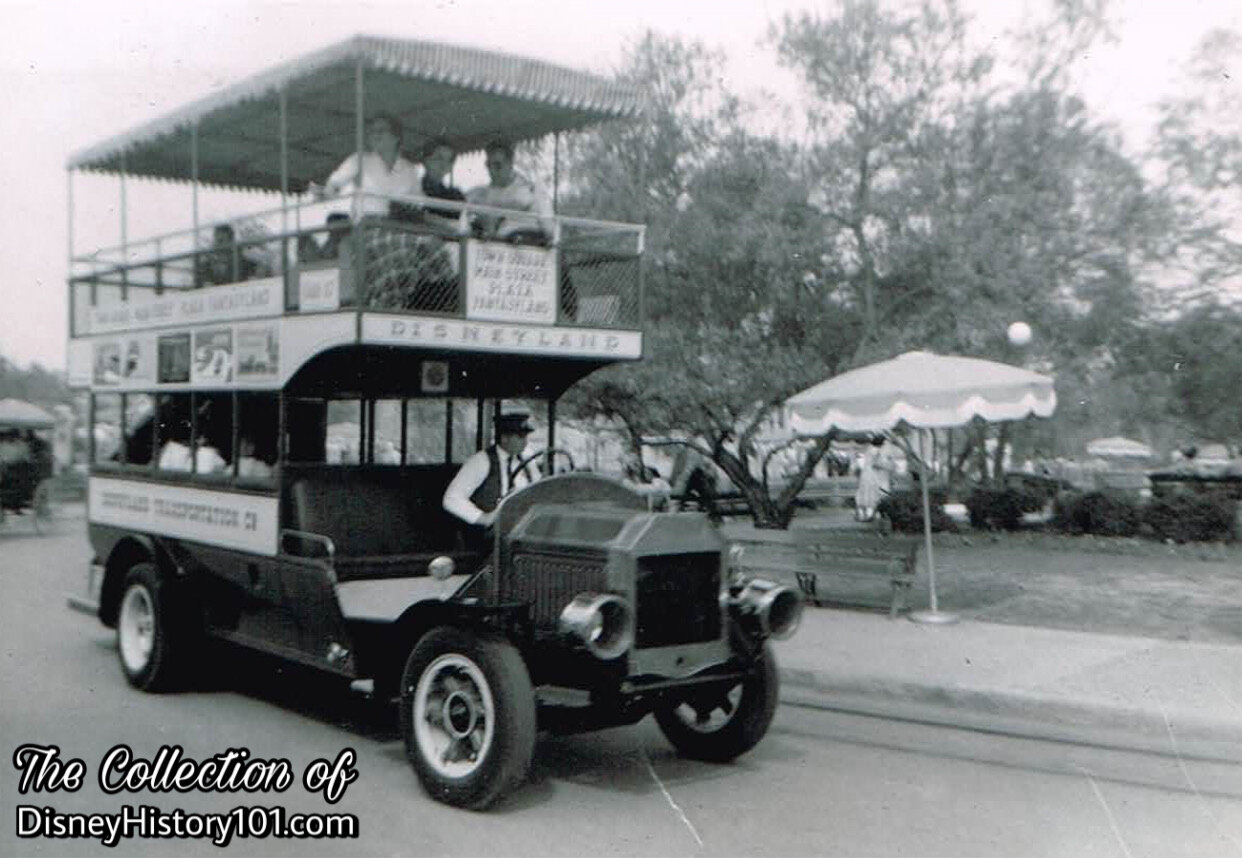
A number of Disneylanders operated the Omnibuses like Homer Holland and Wes Demens (in 1967).
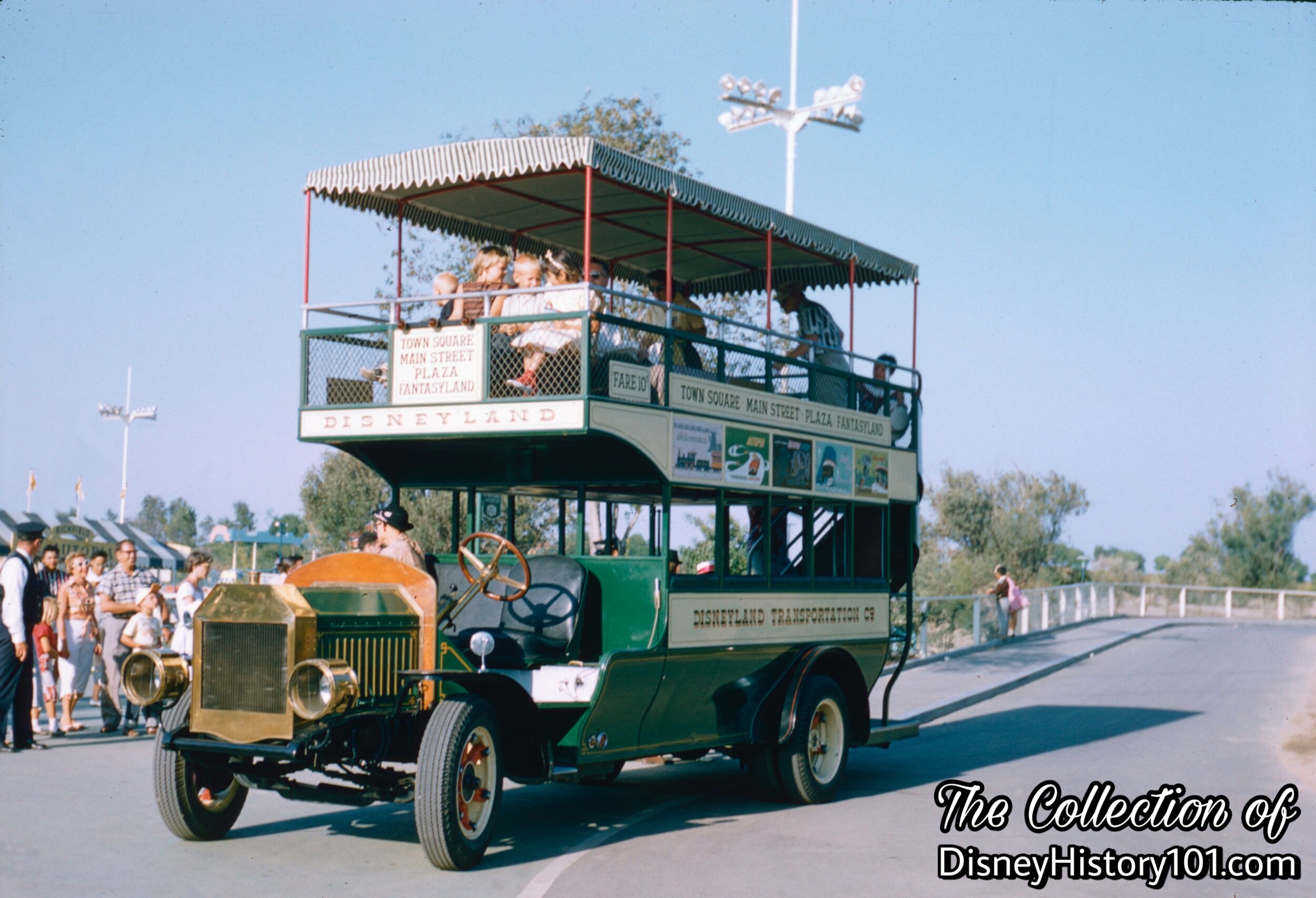
Obviously, the fastest way to move people over the extended areas of Disneyland is with moving vehicles. You’ll note the stops on a sign over the cab - “Town Square, Main Street, Plaza, Fantasyland.” Yes (once upon a time), after a tour through Tomorrowland, the Omnibus arrived at its stop near the Junior Autopia in Fantasyland.

While Skyway Cabins soared over the tree-lined Holiday Hill, the Omnibus circumvented it. It was a Visual Intrusion. Though not evidence of “the real world”, this contradiction to the story was ultimately discontinued as Guests were transported back to the 21st century.
Disneyland is in the habit of selling a belief in fantasy and storytelling, and if the background isn’t believable, people won’t buy it. Marty Sklar recalled “walking through Disneyland with Walt Disney when a publicist drove up to them near the Mike Fink Keel Boats. Disney was horrified: ‘What,’ he asked, ‘are you doing with a car here in 1860?’” This story may explain why the Omnibus operation through Tomorrowland was discontinued. That urge for ersatz-authenticity has lived on into the present.
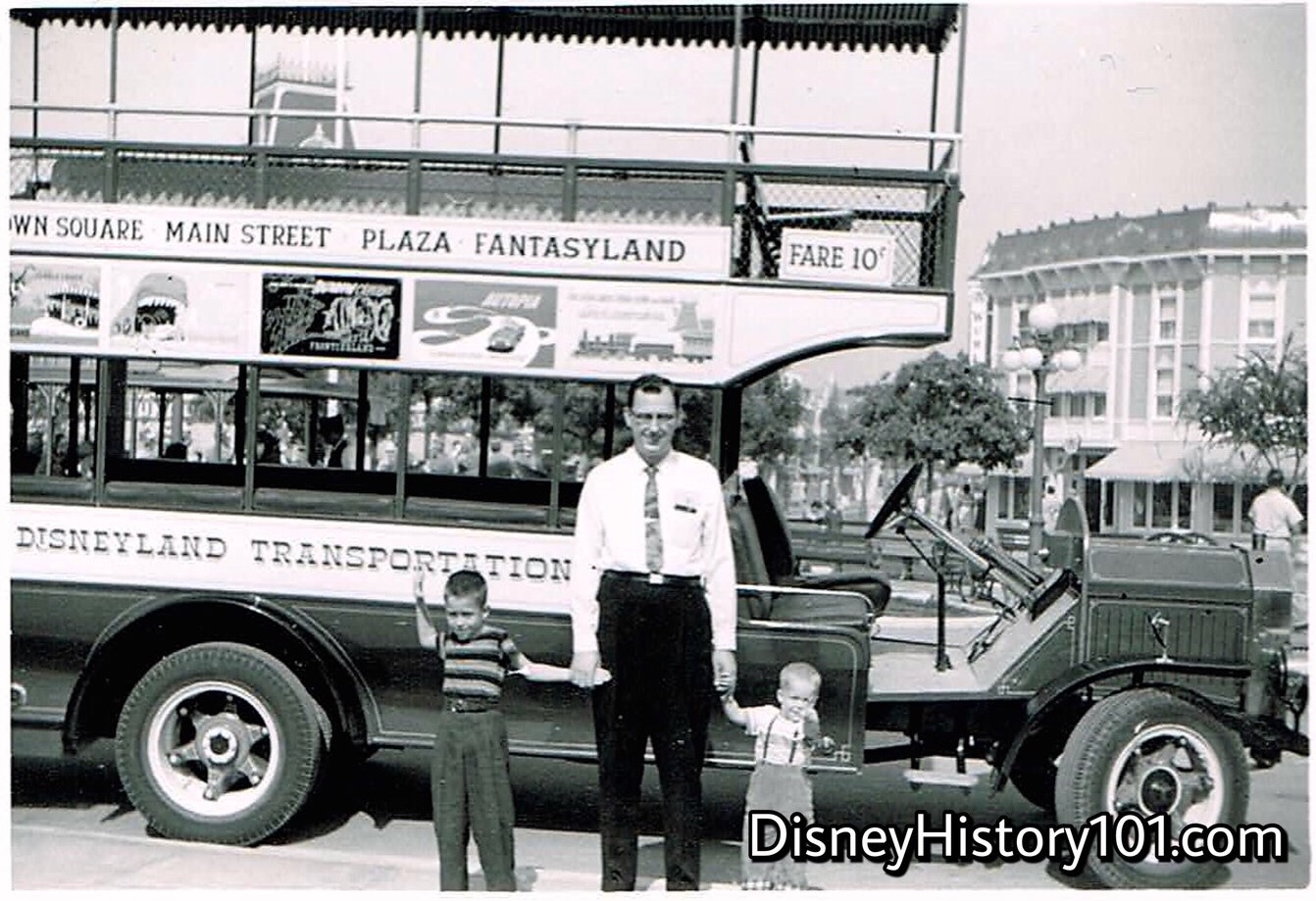
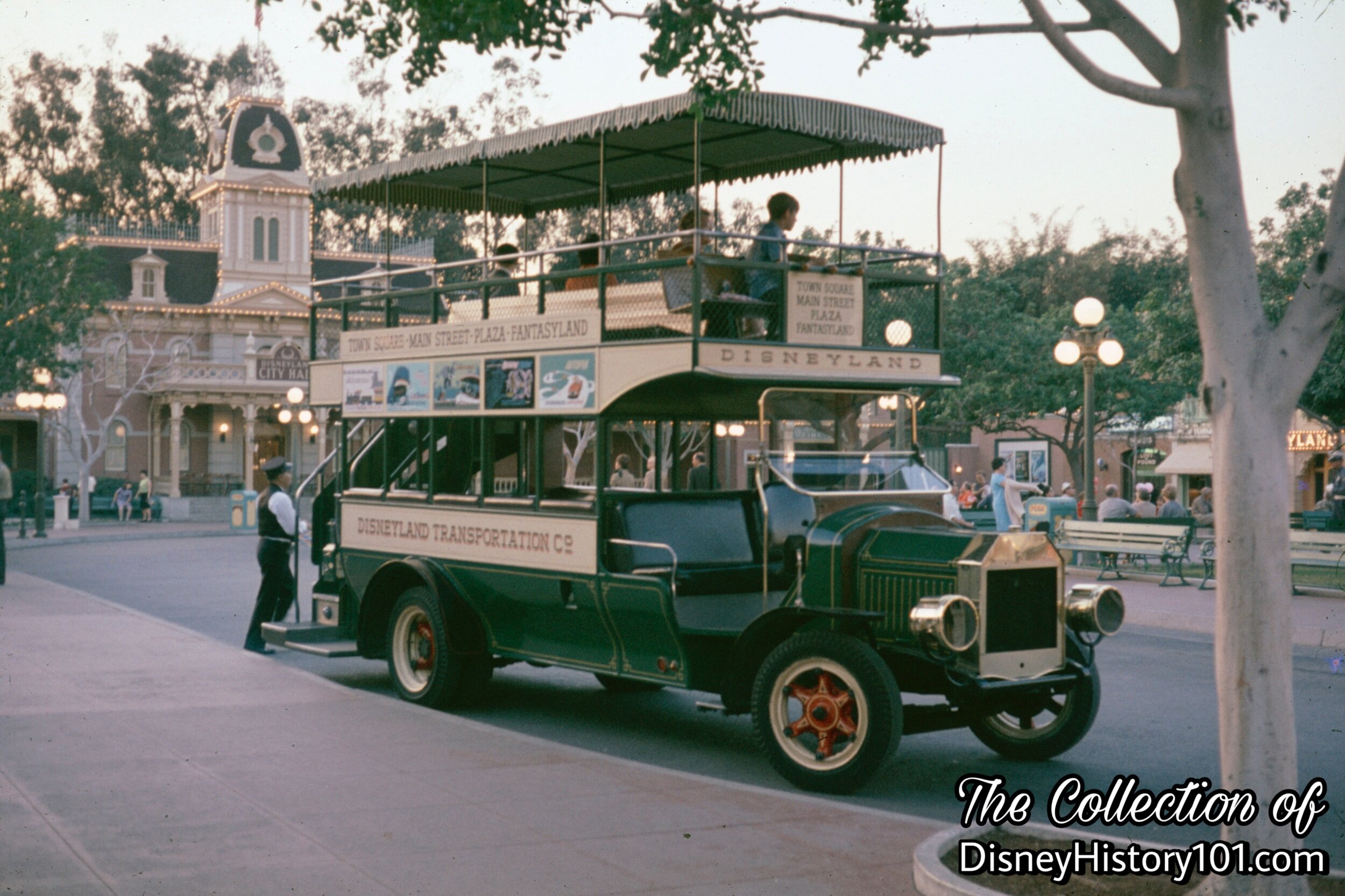

Omnibus #2 (license #J-64561; the same scale as Omnibus #1) began operation the following year, during December 25, 1957. Though it may be unthinkable by Tomorrowland’s current show standards, by 1958 the Omnibuses operated though the two-block length of Main Street and Tomorrowland. Once reaching Central Plaza, the buses entered “a side road to a turnaround at one of Fantasyland’s entrances,” according to one article contemporaneous with the Omnibus’ Disneyland debut!
When preliminary work on the Disneyland Guided Tours began (c. 1958), a ride aboard the Omnibus was included among the stations visited along the route. While aboard, the Omnibus operator generally handled the spiel for Main Street, until guests and their Disneyland Tour Guide disembarked the bus at the entrance to Tomorrowland. At this time (c. 1958), admission aboard an Ominibus (bound for Main Street U.S.A. or Tomorrowland) was one “jumbo” “A” coupon (the price of 10 cents, for one adult), the same as the 20,000 Leagues Under the Sea Exhibit, the Surreys, or the King Arthur Carrousel.
Soon (by September 28, 1958), the Omnibuses were appraised at a value of $27,550 to $32,900 by Bank of America representatives. Omnibus #1 was reconned a Park Asset valued at $20,069 while Omnibus #2 was valued at $26,916.
By the October of 1962, it was common to see just one Omnibus operating daily. This was common during winter operating schedules.
The Omnibuses appeared in many shows, parades and a great deal of visual media. For example, one of the Omnibuses (without its canopy) was used to transport the Elliot Brothers Band down the parade route during the televised “Disneyland ‘59” pageant and parade. One of the Omnibuses was used to transport E.J. Peaker, Kurt Russel, and the Osmond Brothers, as they sing “Down On The Street”, while heading down Main Street, in the c.1970 “Disneyland Showtime” episode of “The Wonderful World of Color”. One of the Omnibuses was also notably used to transport members of the All-American Singers down Main Street during the American Bicentennial celebratory year (from 1975 through 1976).
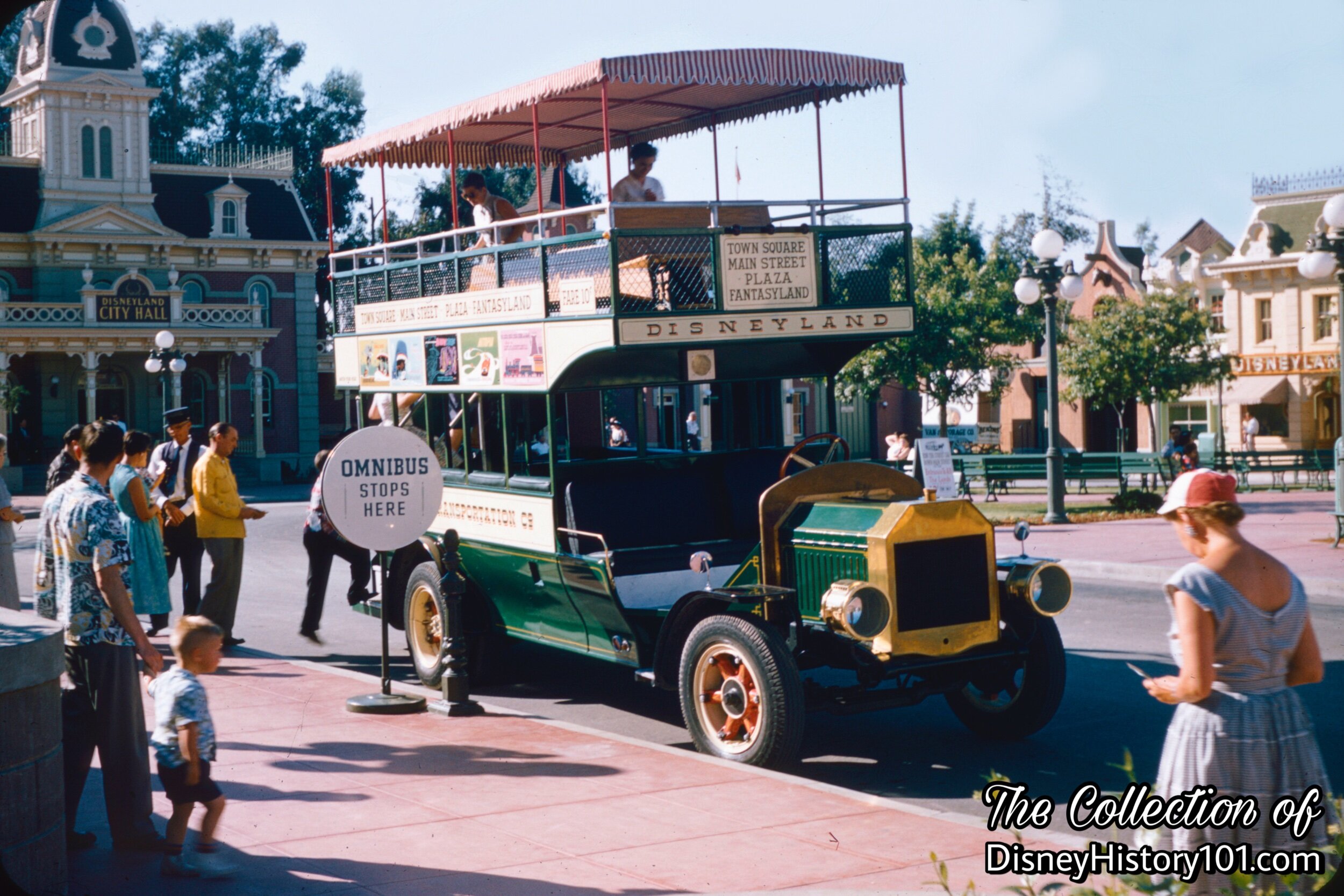
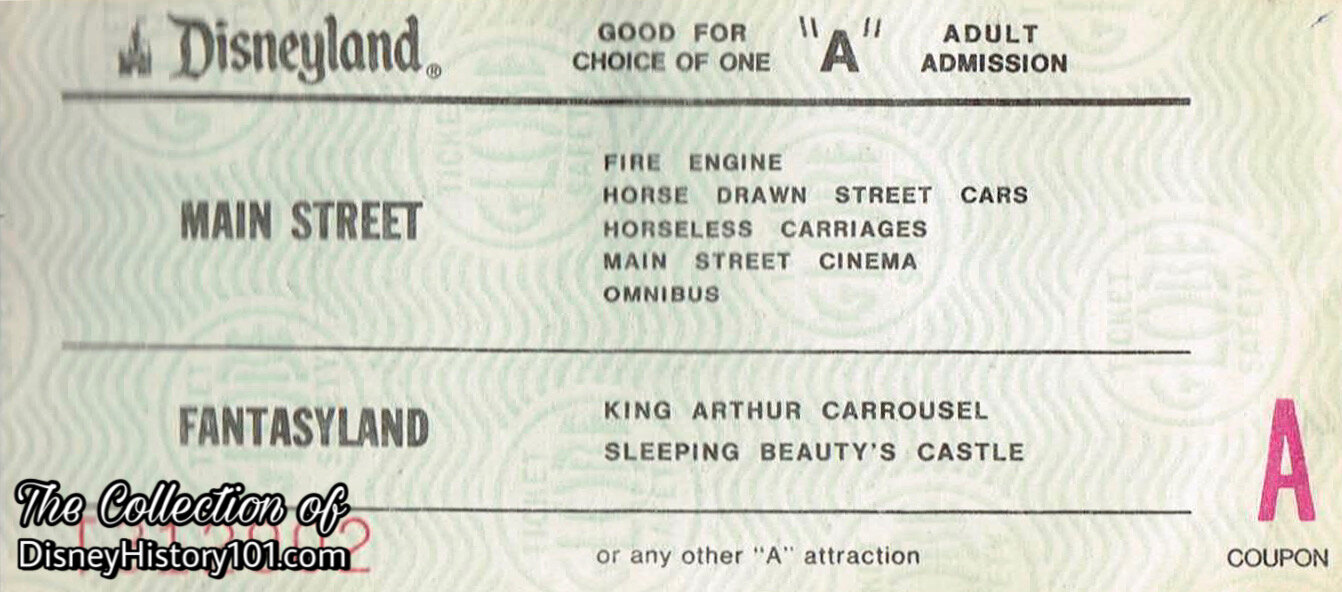
Once upon a time, when guests boarded one (of two) Omnibuses (or any DMC, including the Horseless Carriages), the fare was payed with either a Disneyland Letter denomination Coupon, or a small amount of change currency. When Guests payed with coins, they were deposited in a meter, which was attached to the front passenger side of the vehicles.
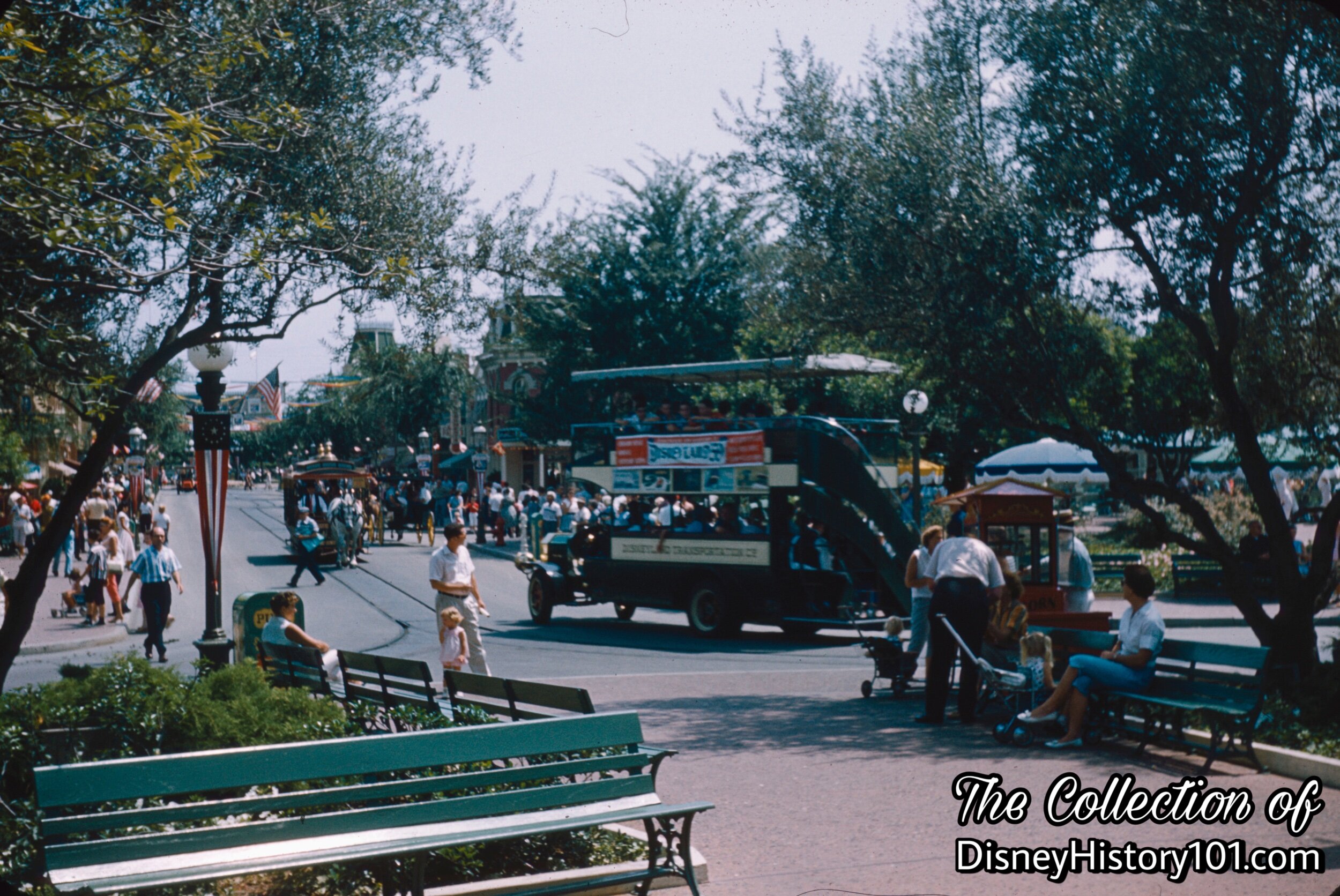
If you look closely, you can see the Ominibus’ banner advertising the six new attractions of 1959! Notice how the “Disneyland Dictionary” (published October 1958) described the route of the two (Disneyland Transportation Co.) double-decker buses: “Town Square, down Main Street, through Plaza and around Matterhorn. Return trip - Matterhorn, through Plaza, Main Street to Town Square.”


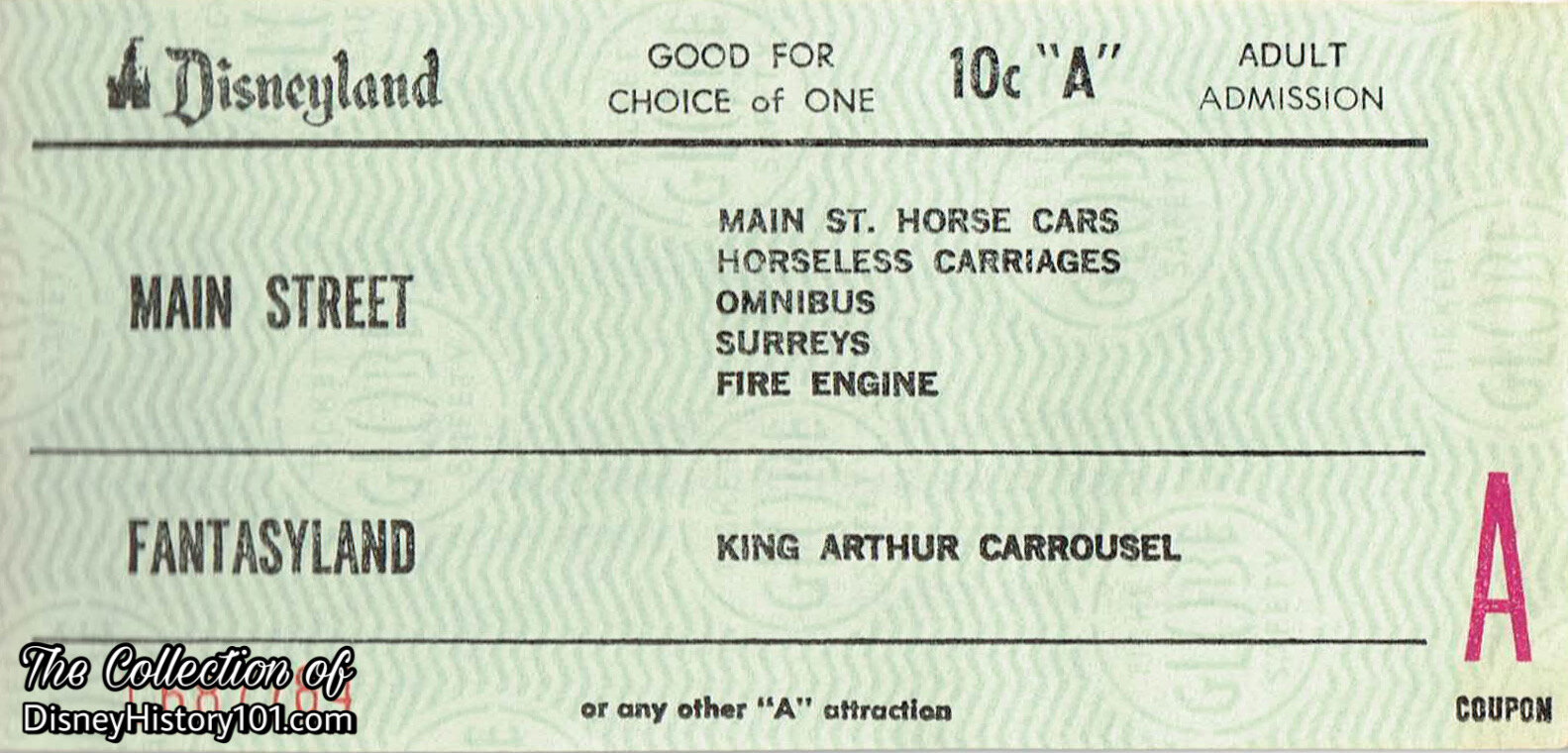
By 1959, Joe Fowler was Vice President of Disneyland Operations Committee and Doc Lemmon of Disneyland Operations was overseeing Operators of Rides & Amusements (like the Omnibuses), Livestock, Parking Lot, and Ticket Sellers.
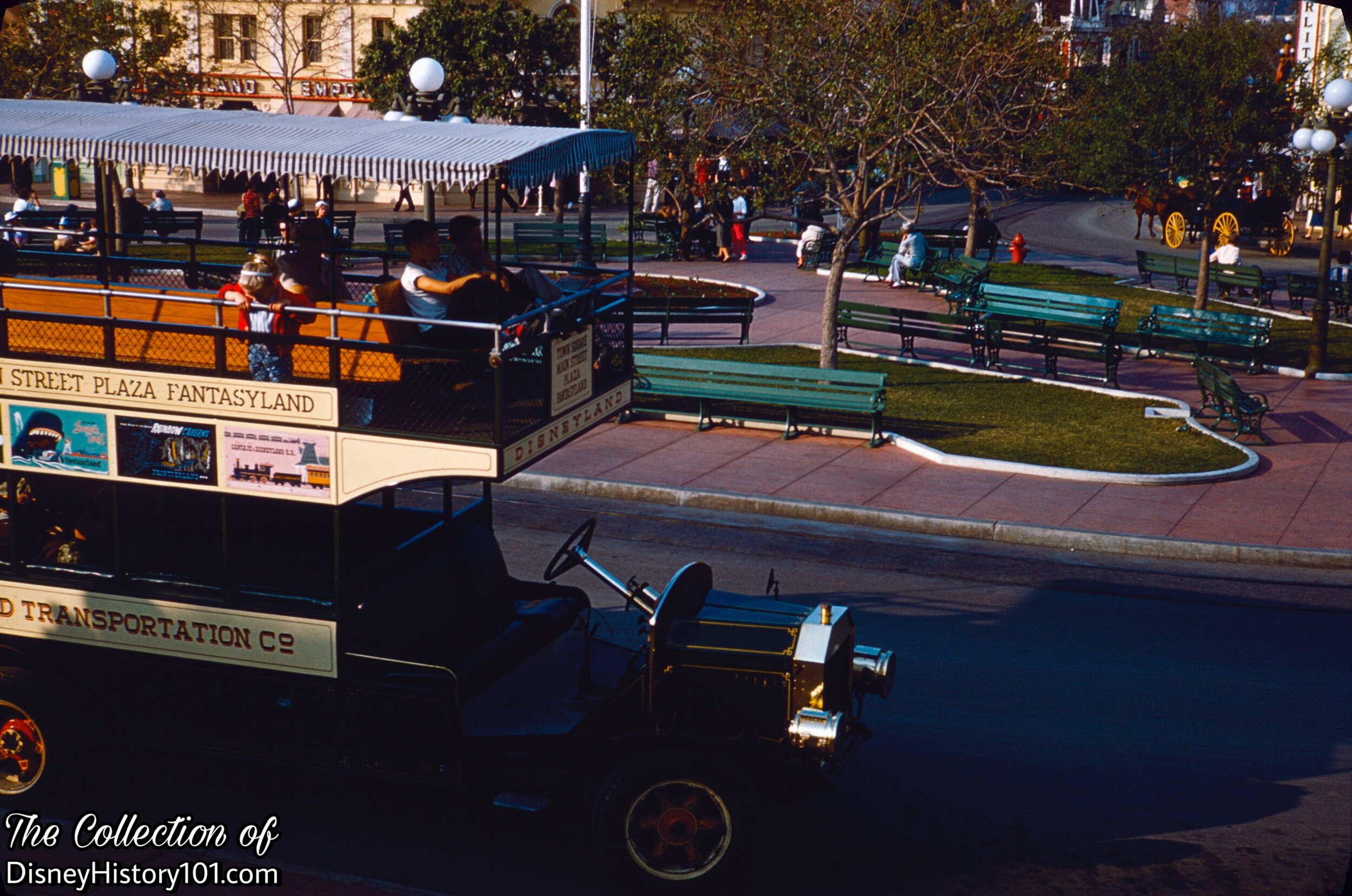
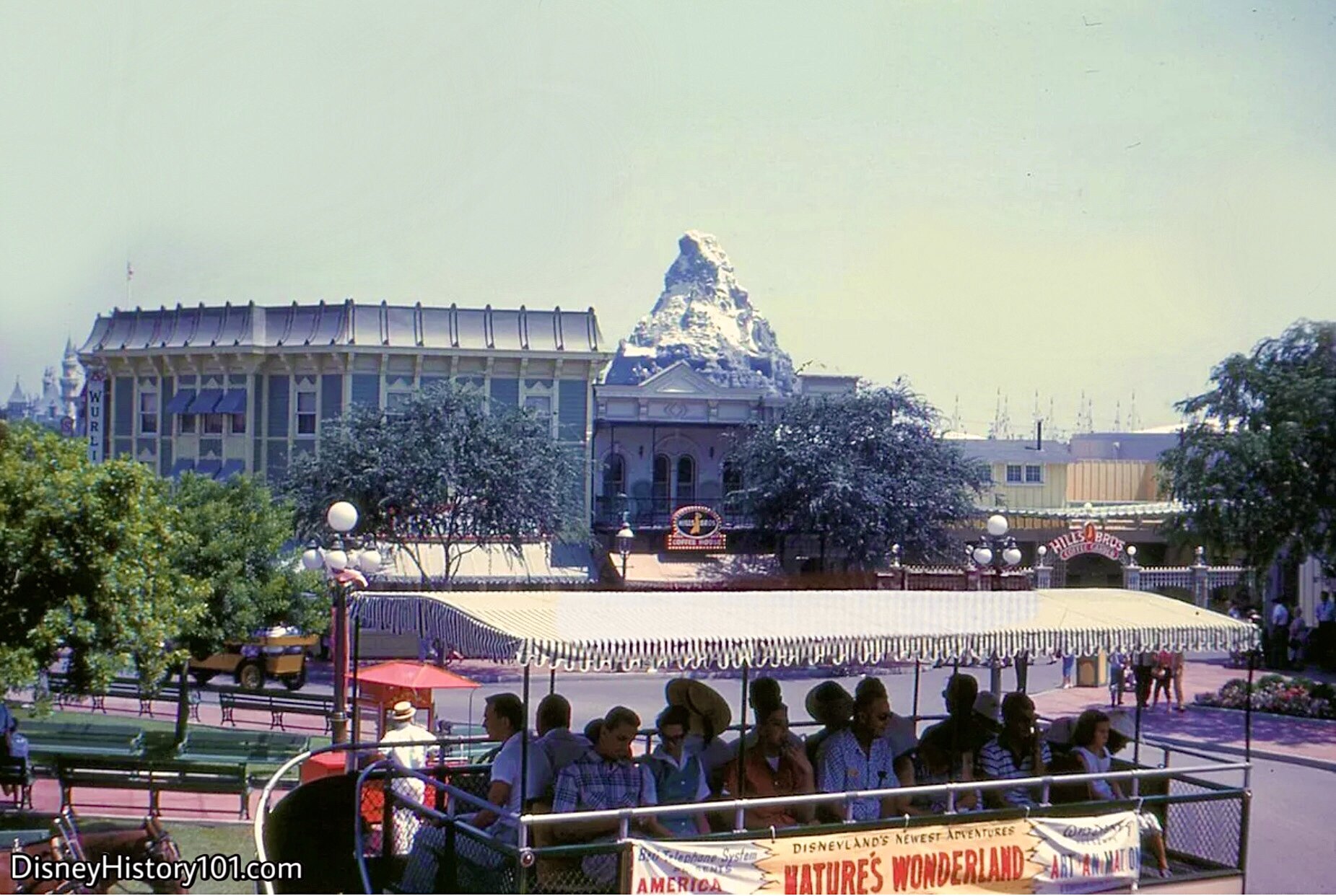
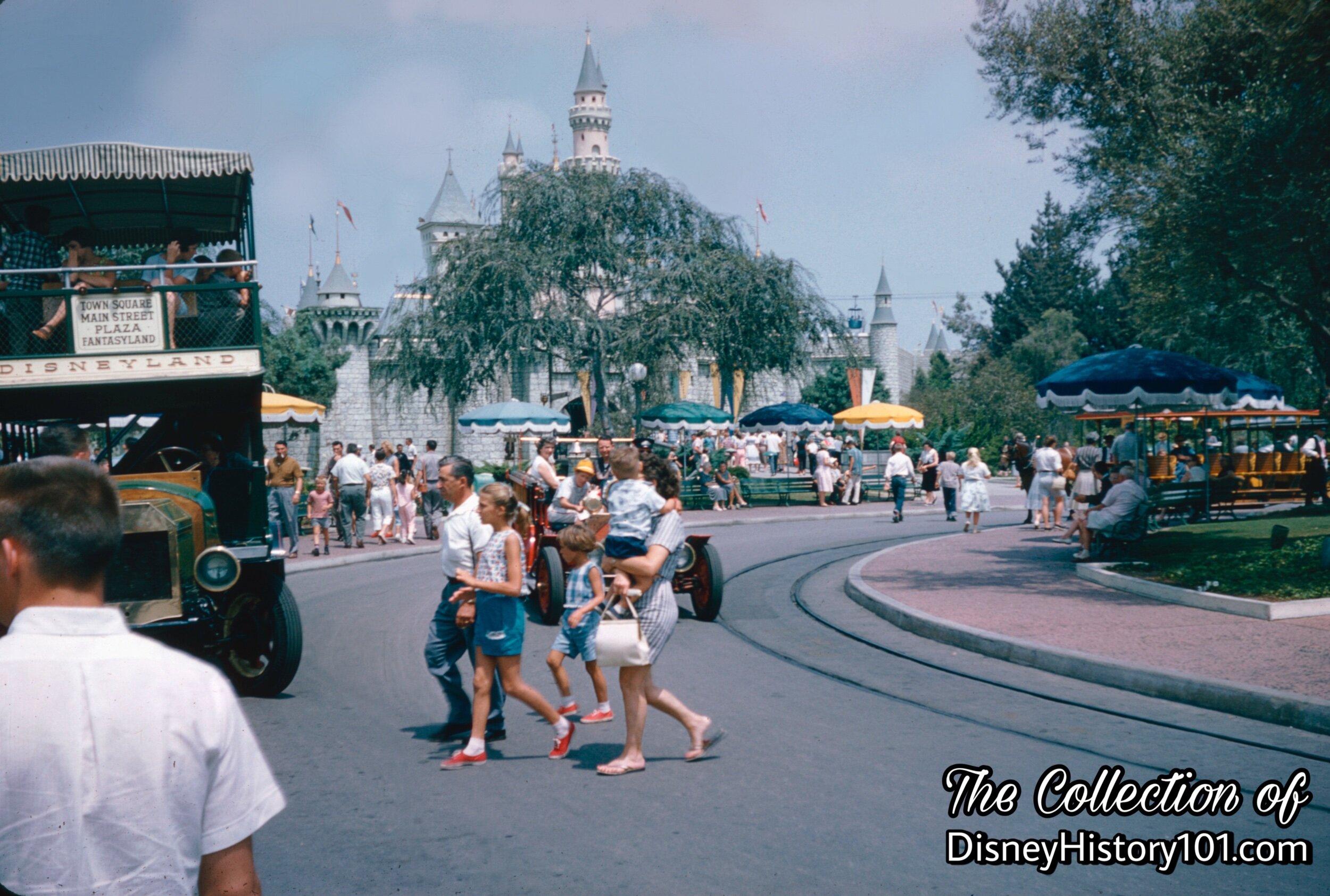
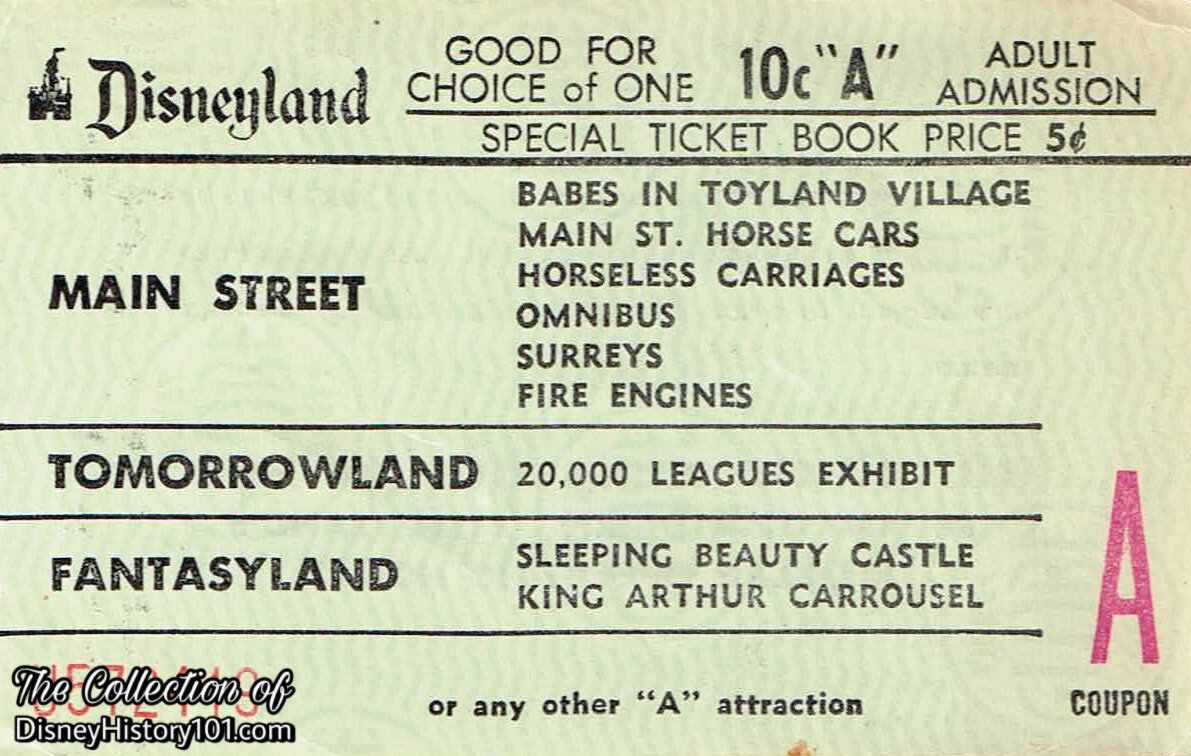
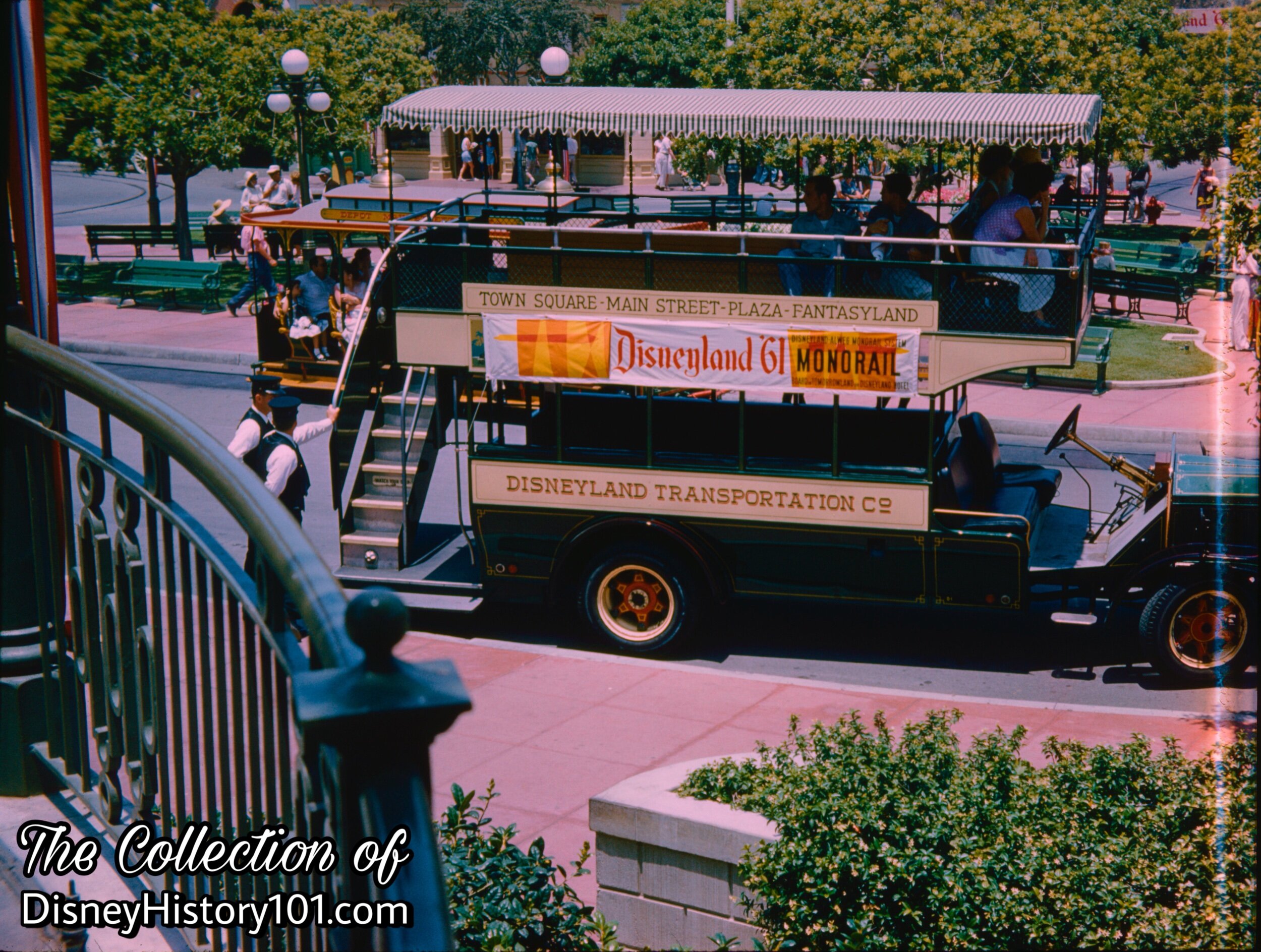
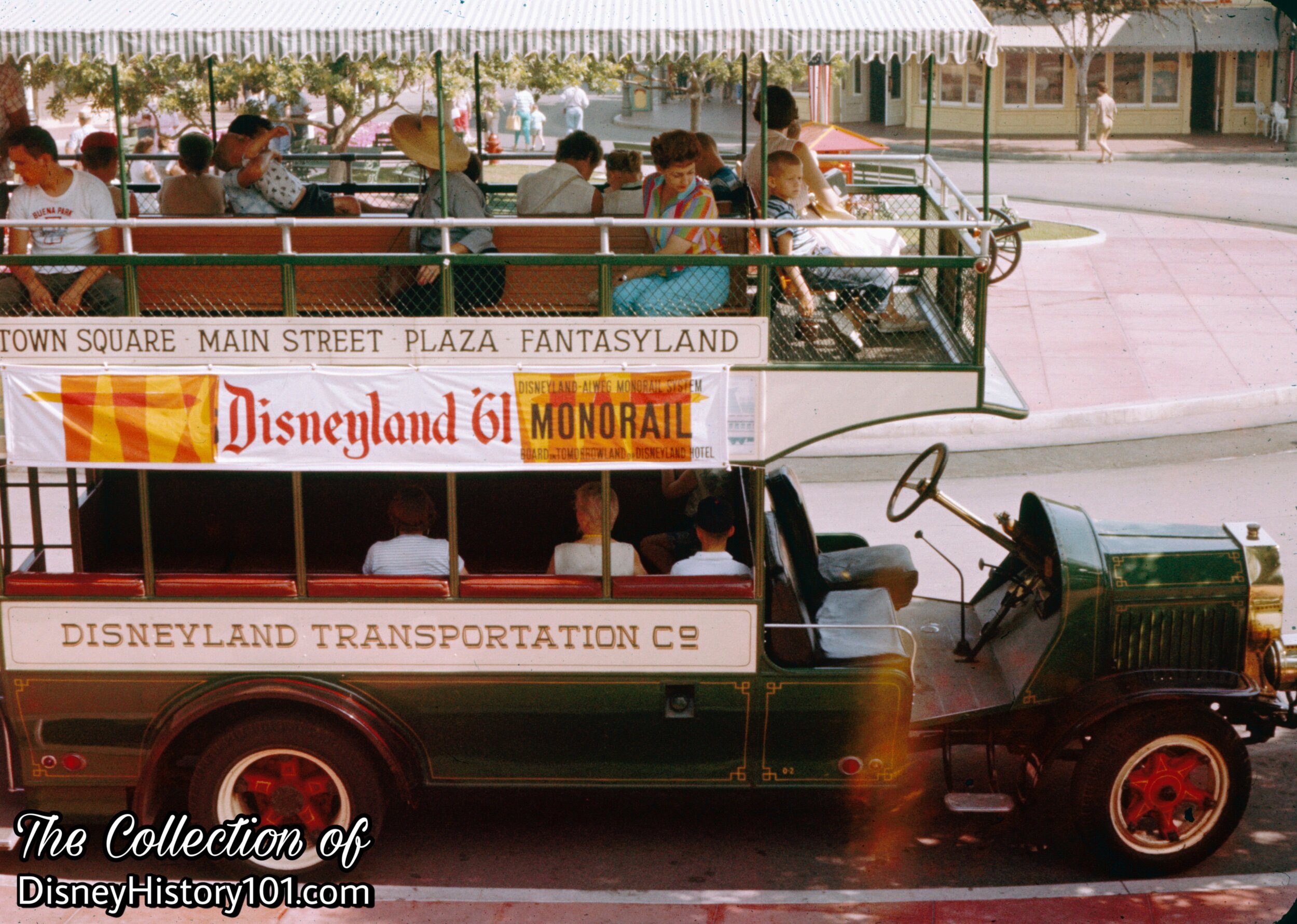
When the Monorail reopened with its new route to the Disneyland Hotel, the Omnibus heralded this new line along the side of the Omnibus!
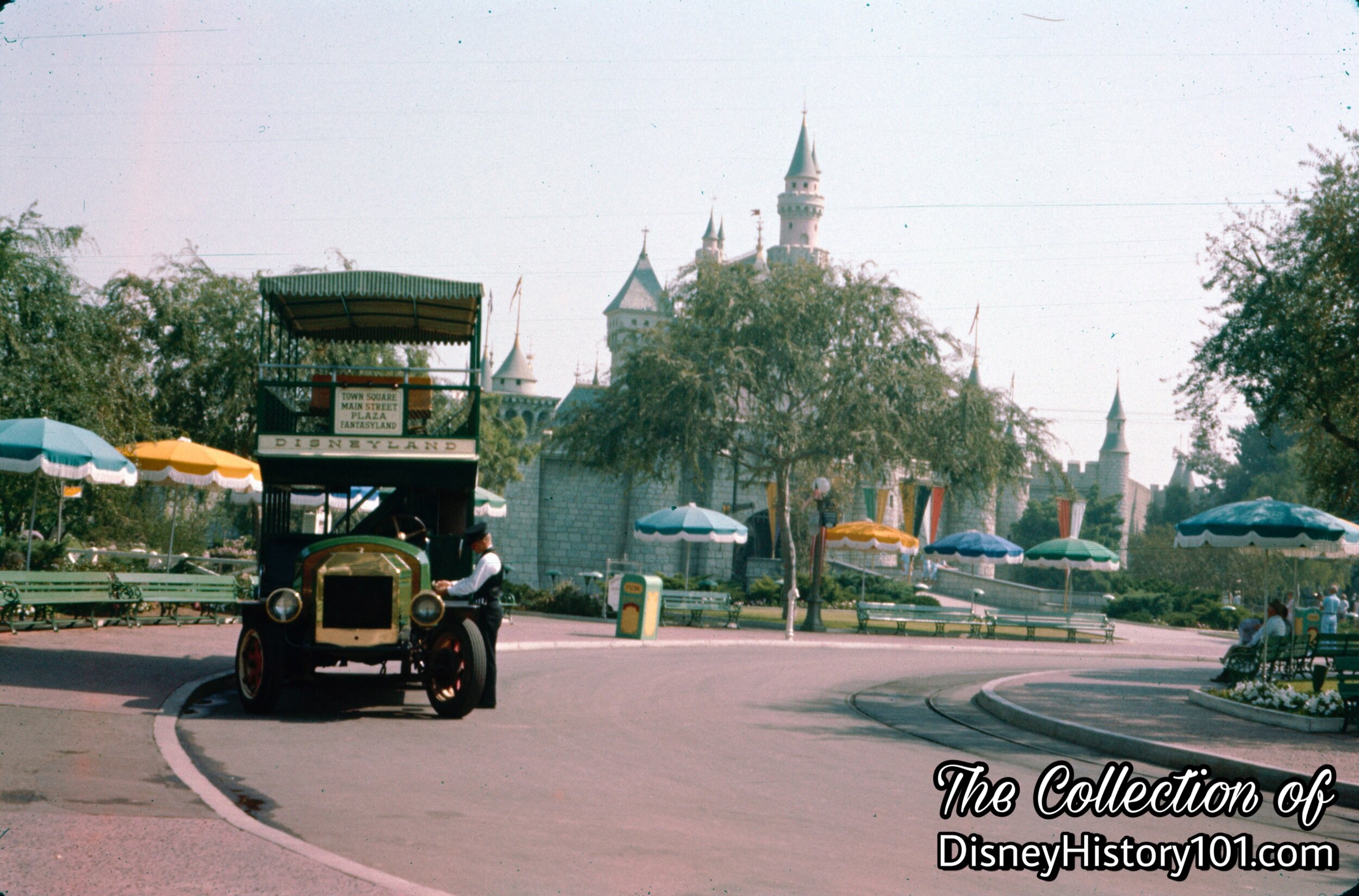
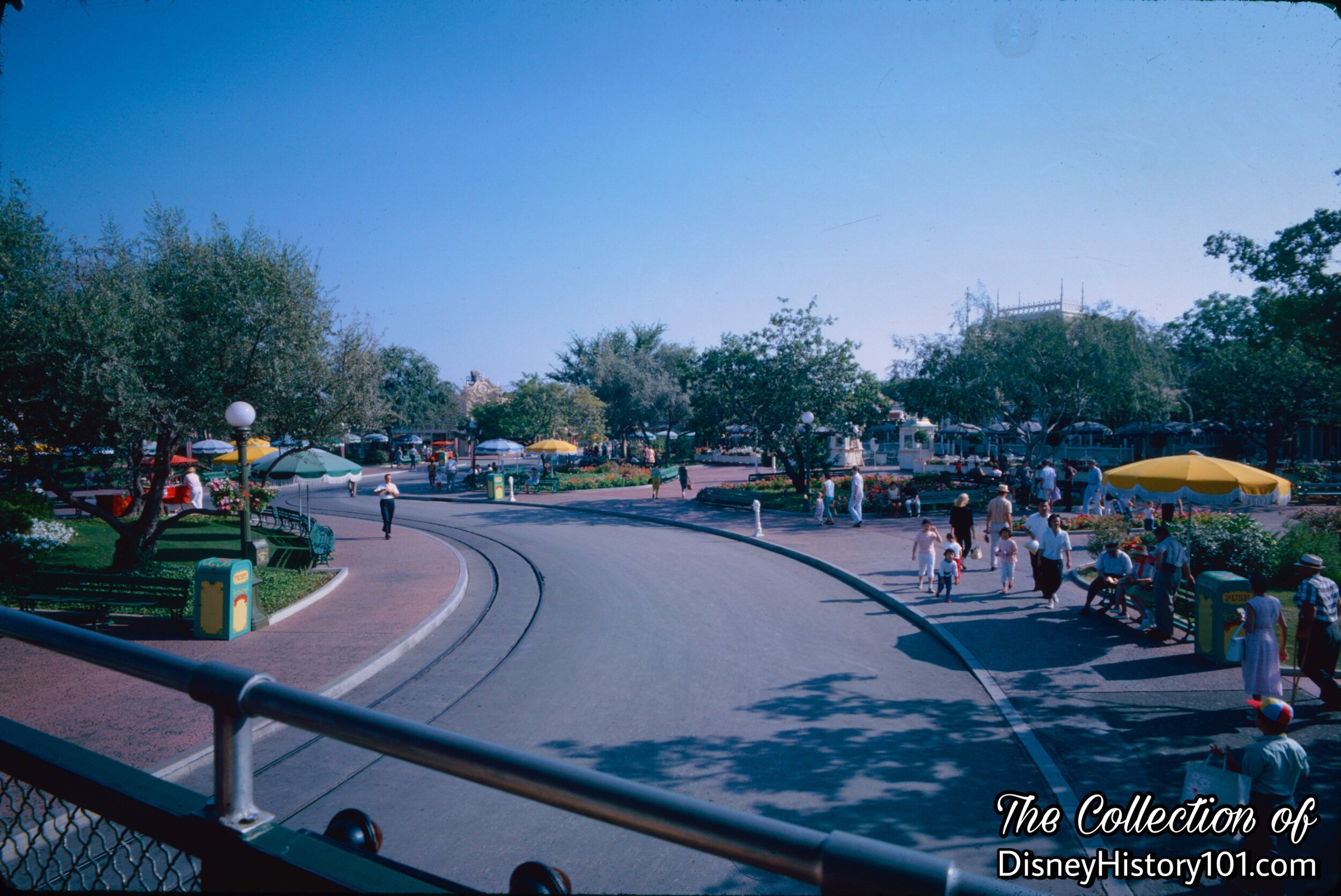
The Omnibus offered a wonderful panoramic of Town Square, Main Street USA, and the Plaza. Owing to this, in August of 1962, Lloyd Richardson, Larry Clemmons, Joe Marquette, and Jack Leppert (of the Walt Disney Studio) filmed and shot scenery from the Omnibus for Studio Production #3185.
The Omnibus operated with one unit during weekdays and week ends during the winter season of 1962. The “Ride Operating Schedule” effective October 3, 1962 described the attraction as having a 280-Guest capacity during winter week end days and a maximum daily capacity of 560 Guests.
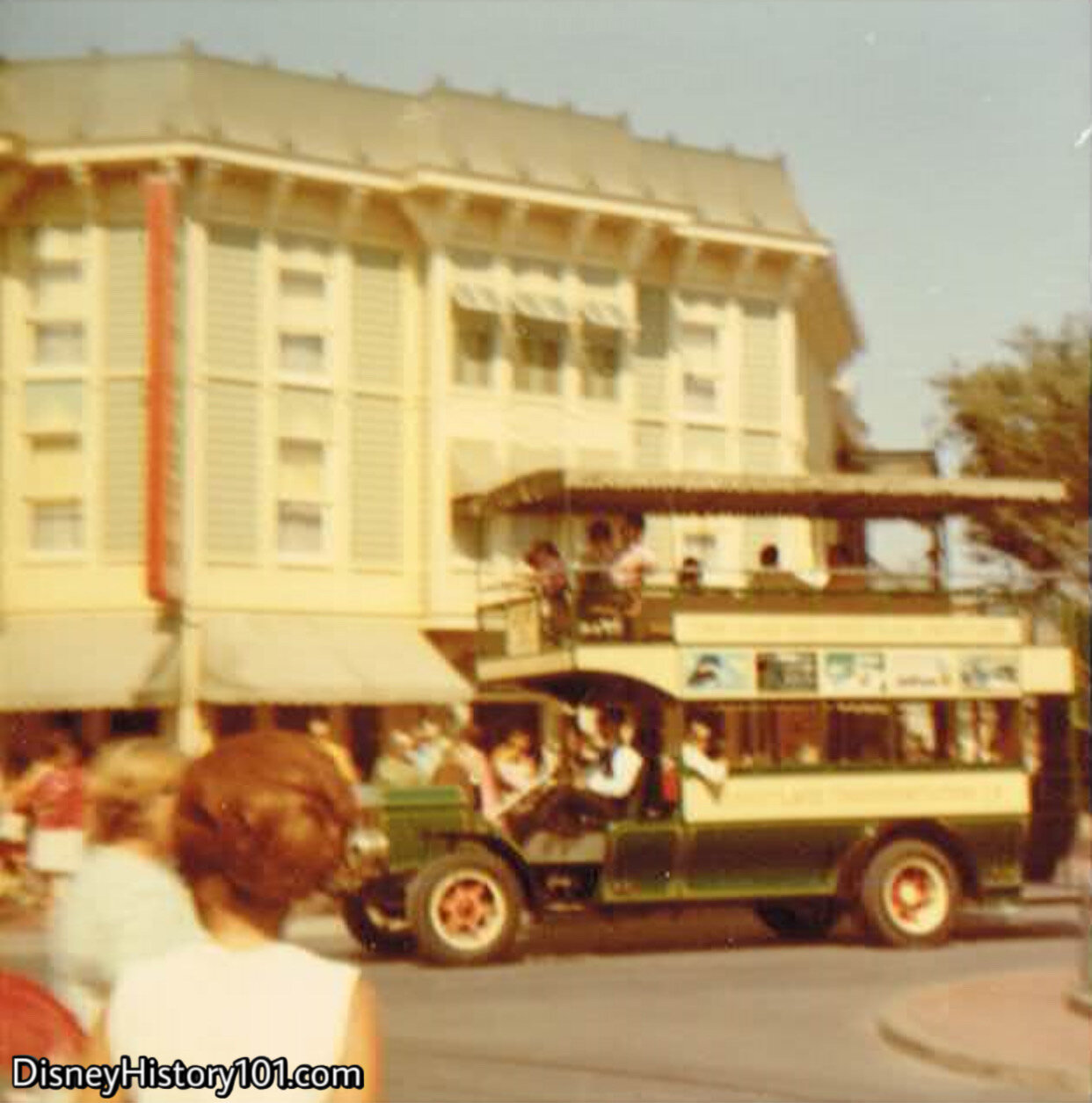
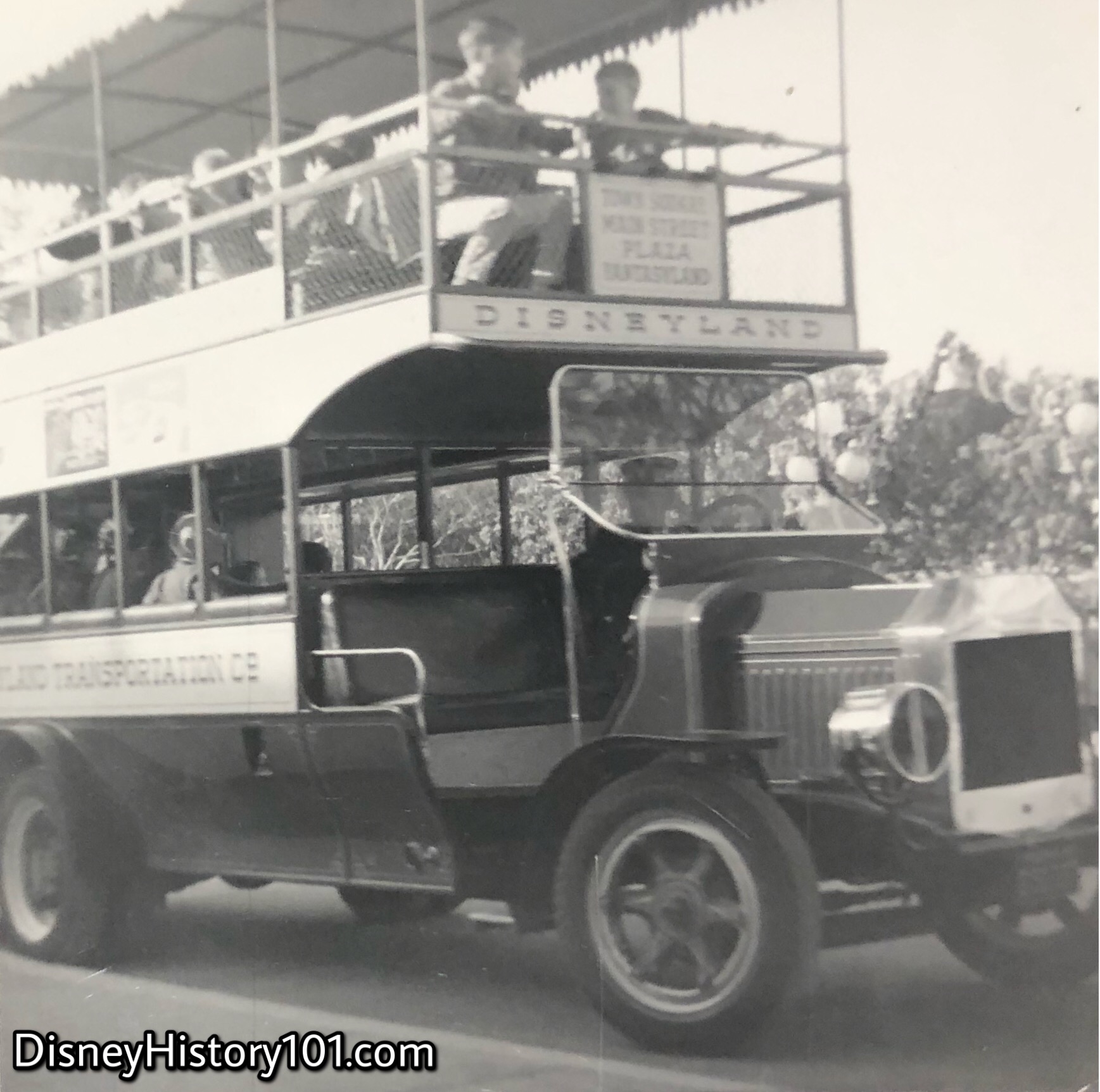
The importance of the attraction ceasing operation during performances was emphasized in a short piece published in Backstage Disneyland, 1965: “JACK WHITTINGTON, Main Street foreman, will always remember the day the Chinese Girls Drill Team performed on Main Street. The girls paraded up to Carefree Cor-ner, gave an interesting exhibition of their skill, and then marched back down the street to presumably make their exit. So Jack gave the order for the vehicles to resume their usual functions. Much to his amazement, half of the Drill Team wheeled around and started another tour up the street. This must have been a sight to behold. There they were girls marching, with drums beating, batons flying, whistles blowing, trying to dodge street cars, Omnibuses, and horseless carriages with their horns honking and bells ringing. There's never a dull moment for the Main Street Supervisors.”
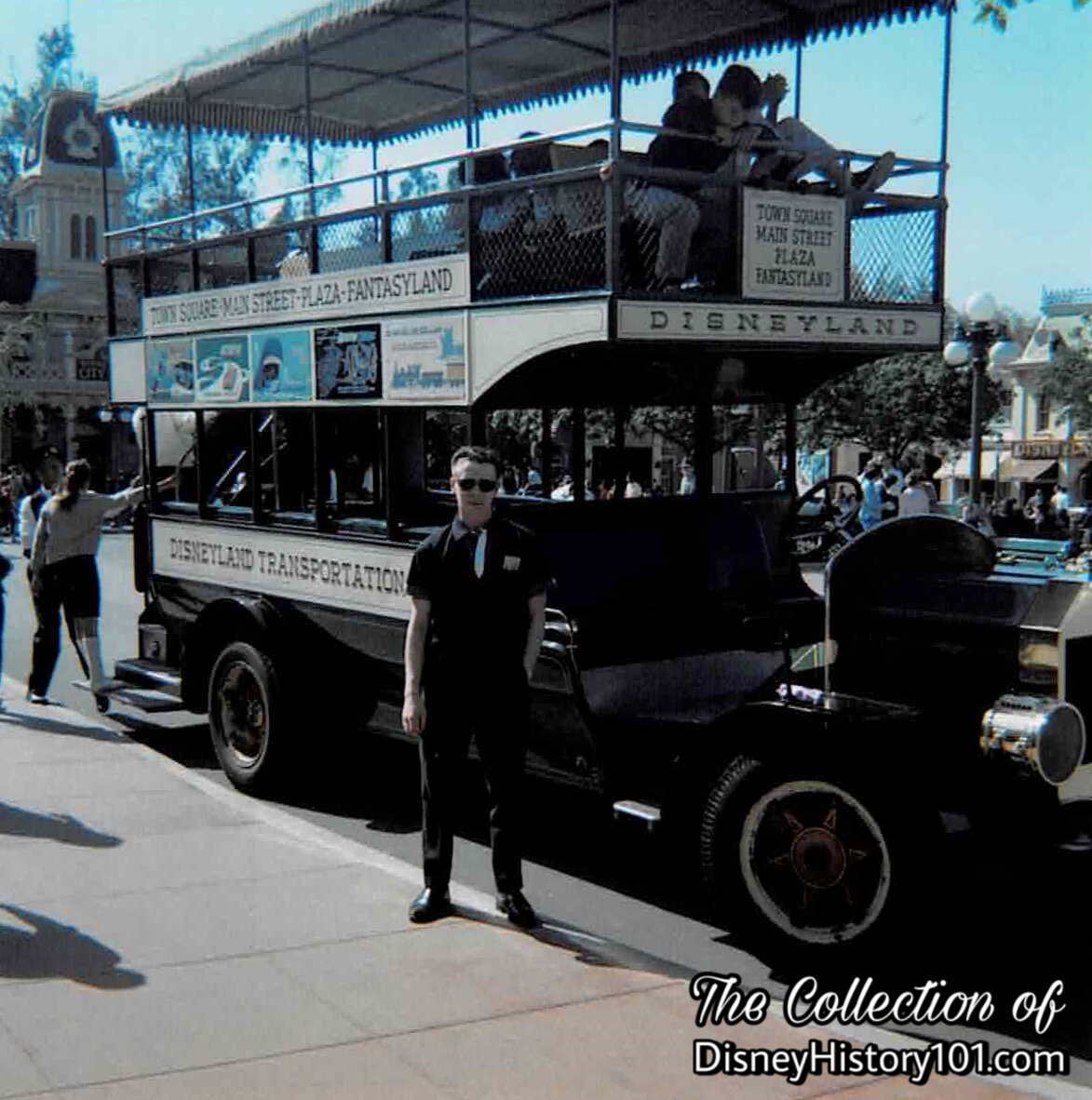
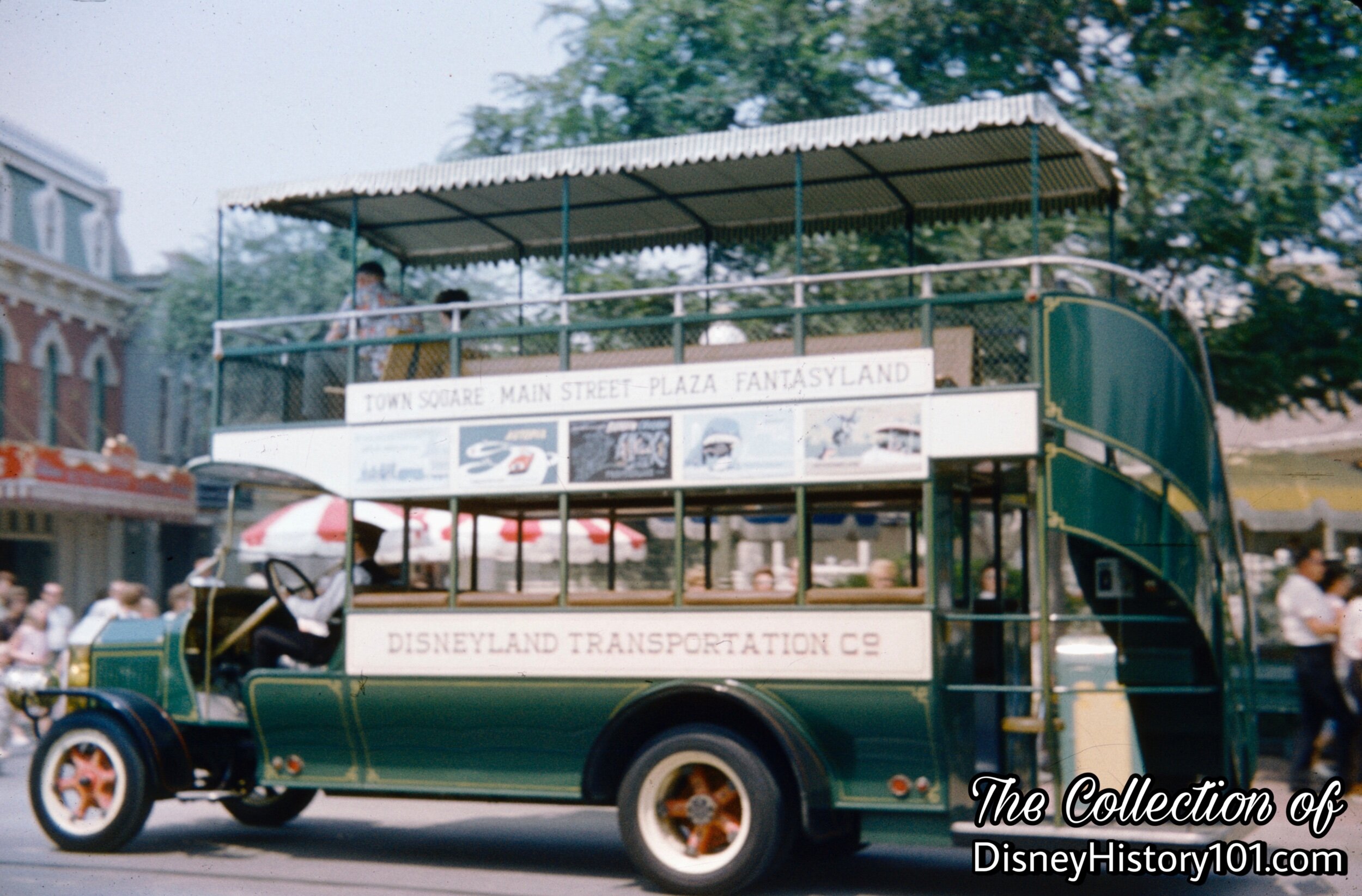
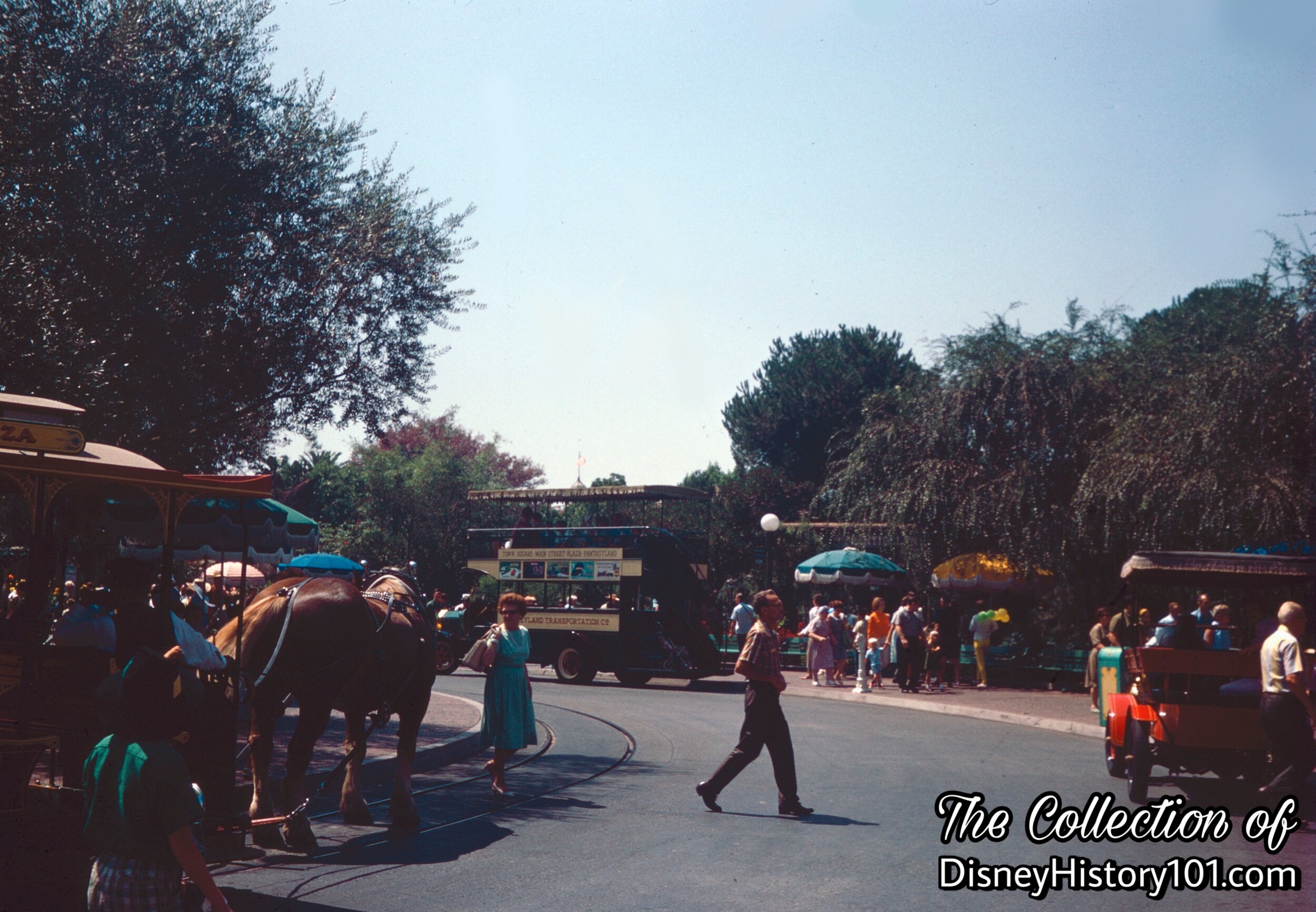
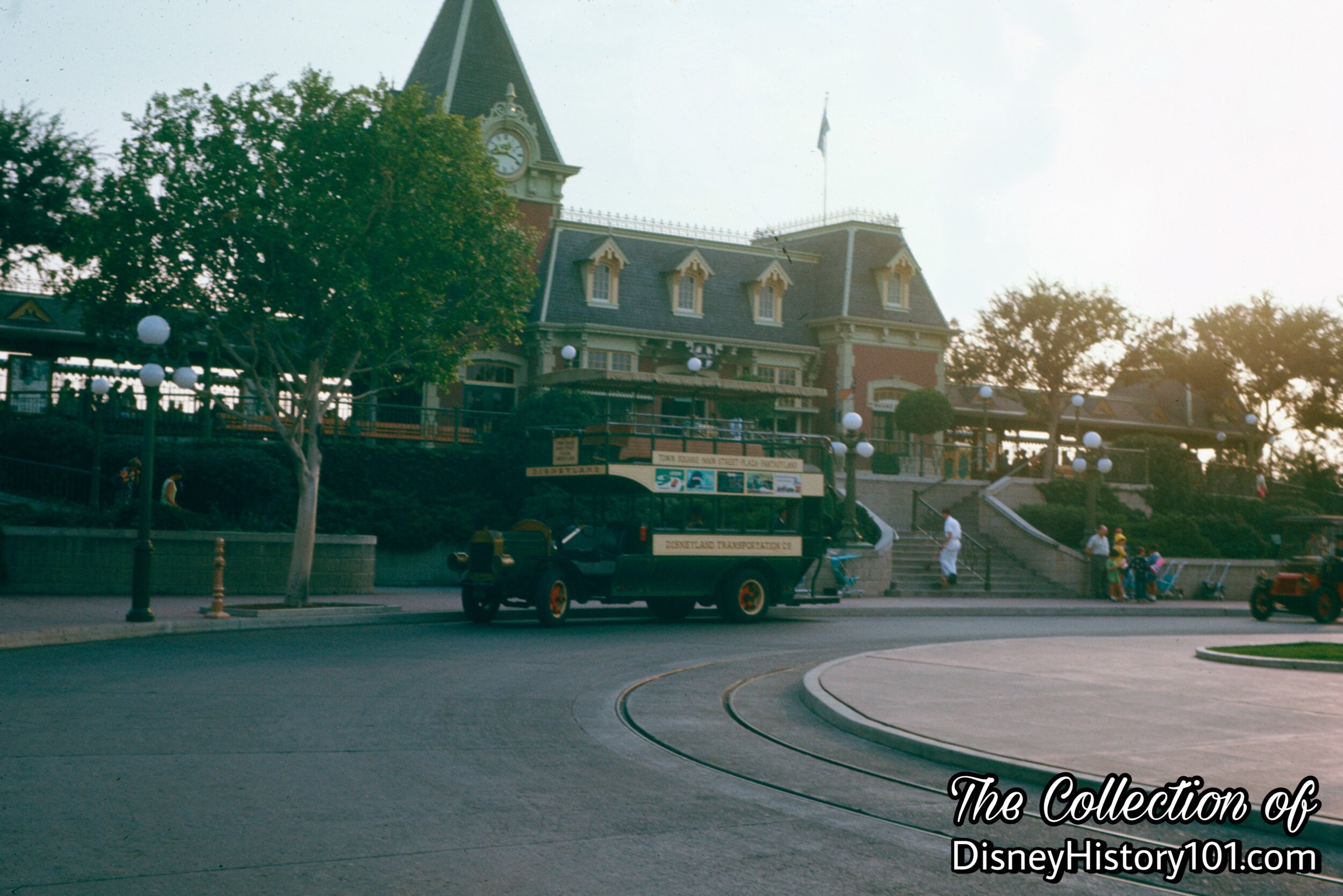
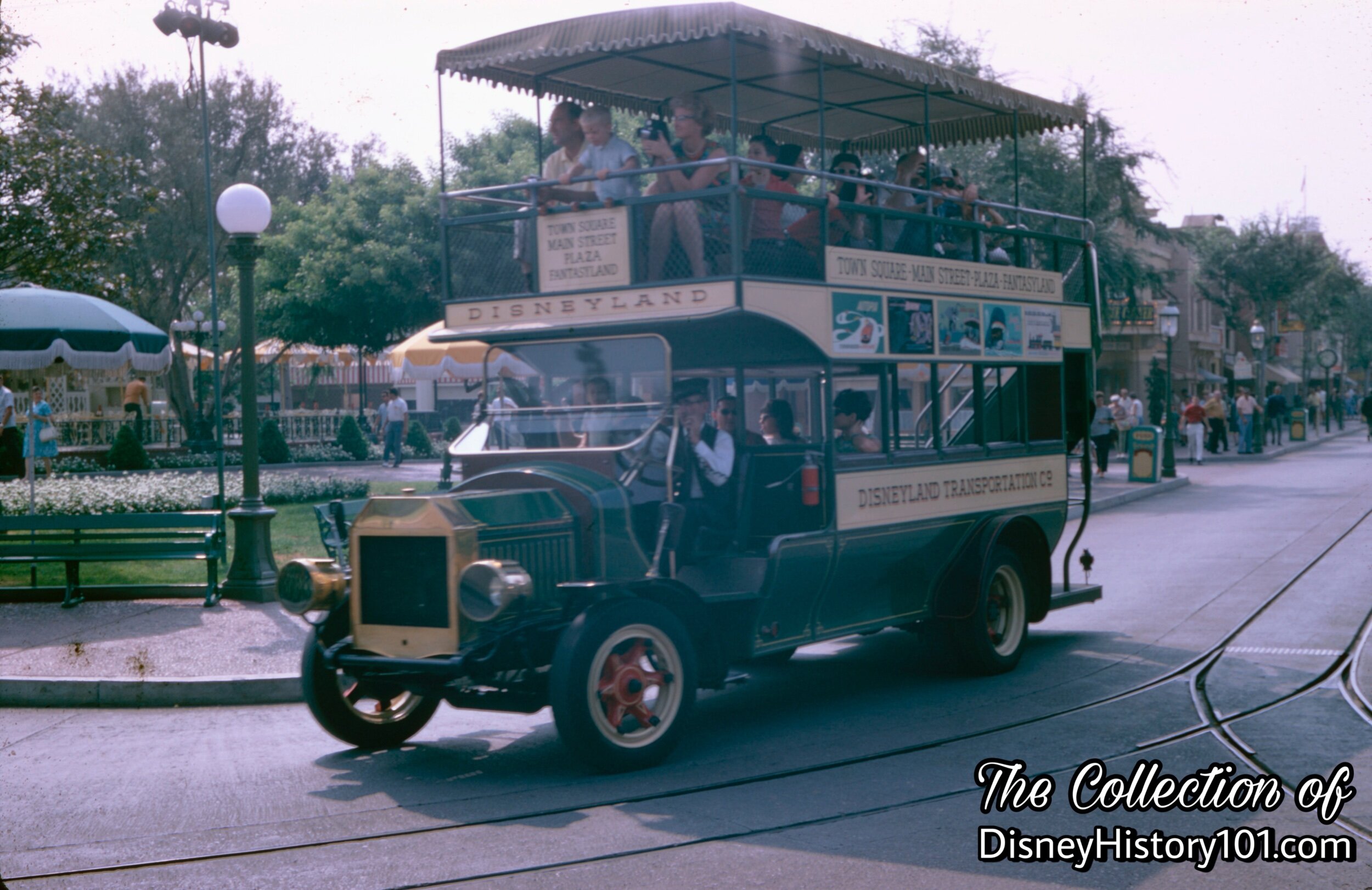


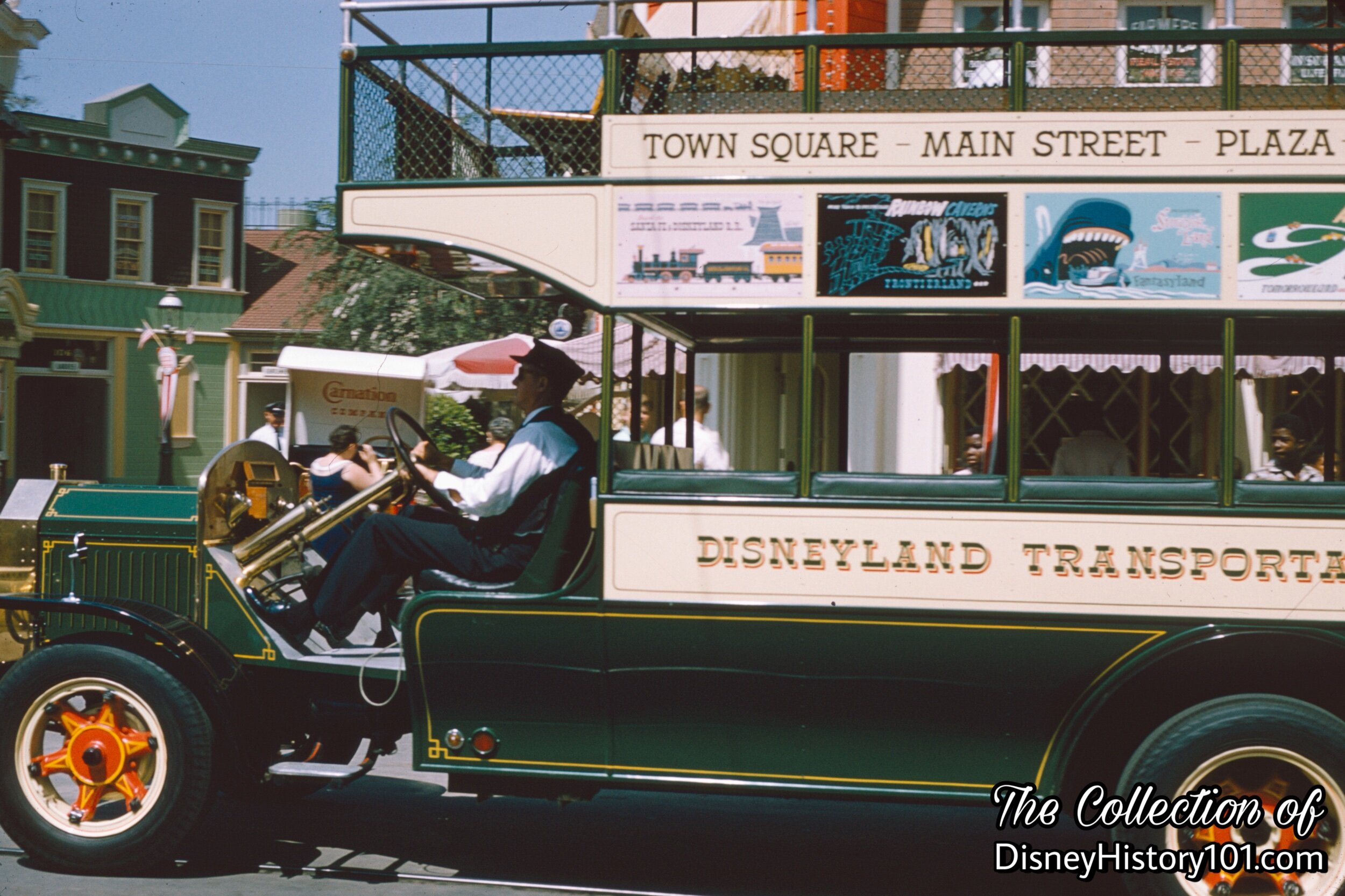
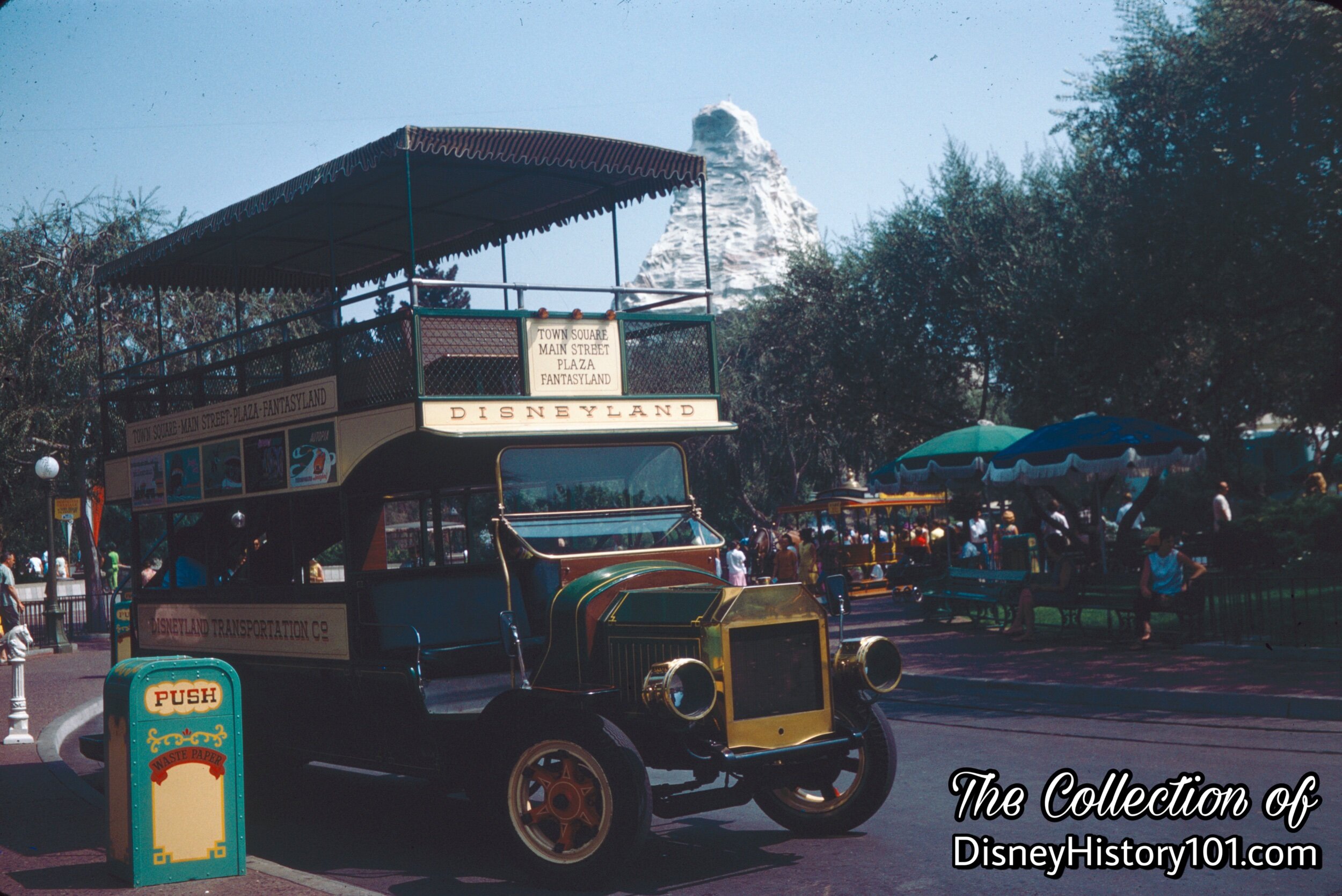
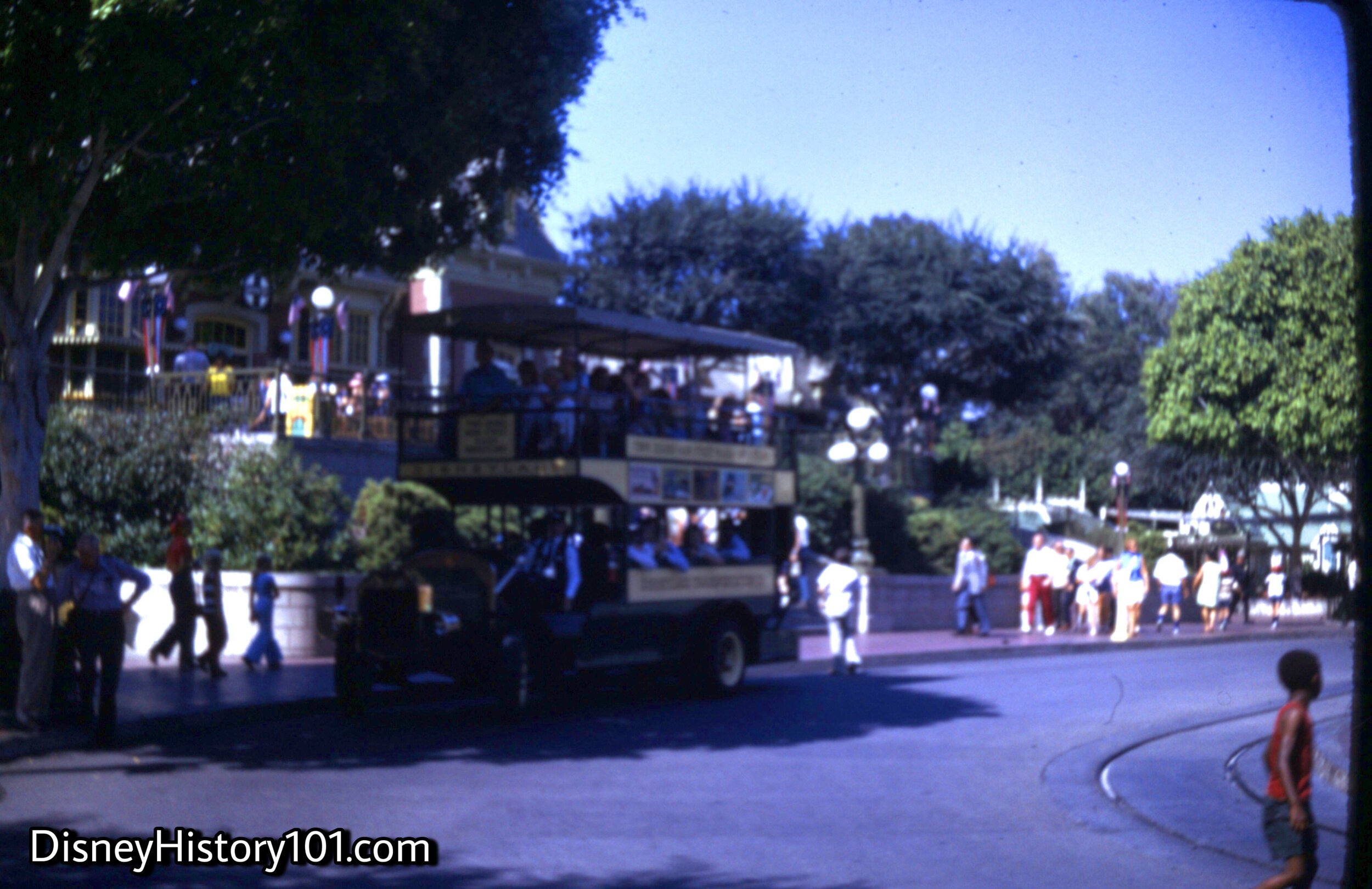
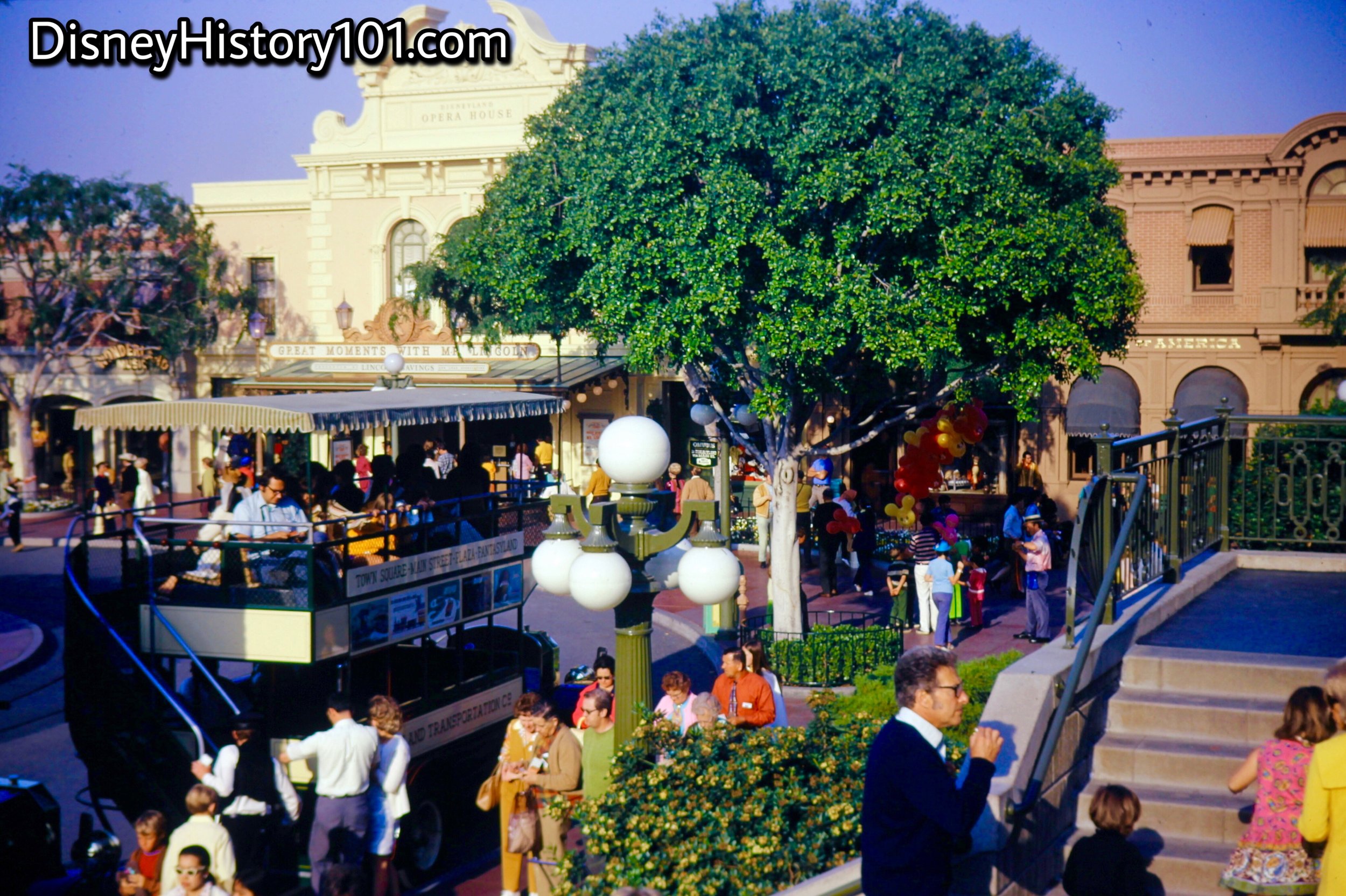
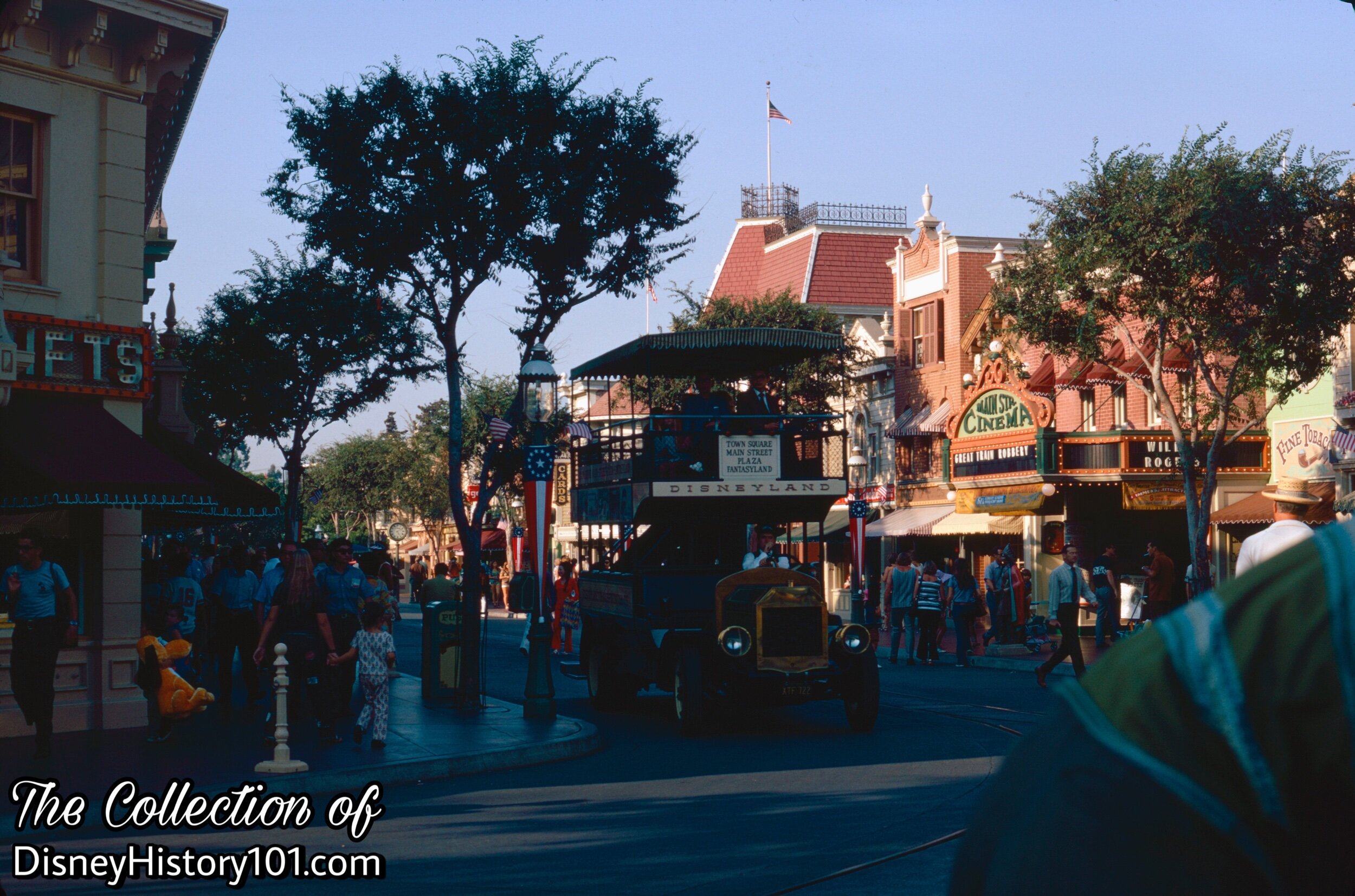
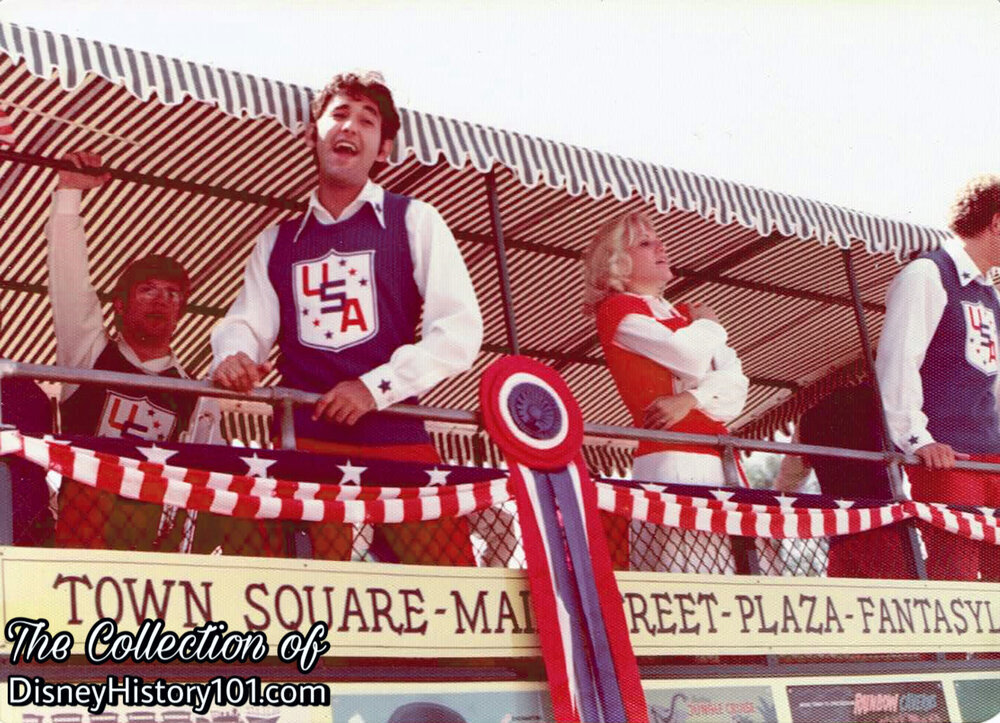
The Omnibus was often utilized during parades. During “La Fiesta de Cinco de Mayo Parade” of May 3 & 4, 1969, the Omnibus was driven by Operations with 40 Corina Valdez Dancers on board throwing serpentine confetti. More than a decade later, the Omnibus was decorated with red, white, and blue ribbons and bunting for the American Bicentennial celebration and carried the All-American College Singers down Main Street, U.S.A.!
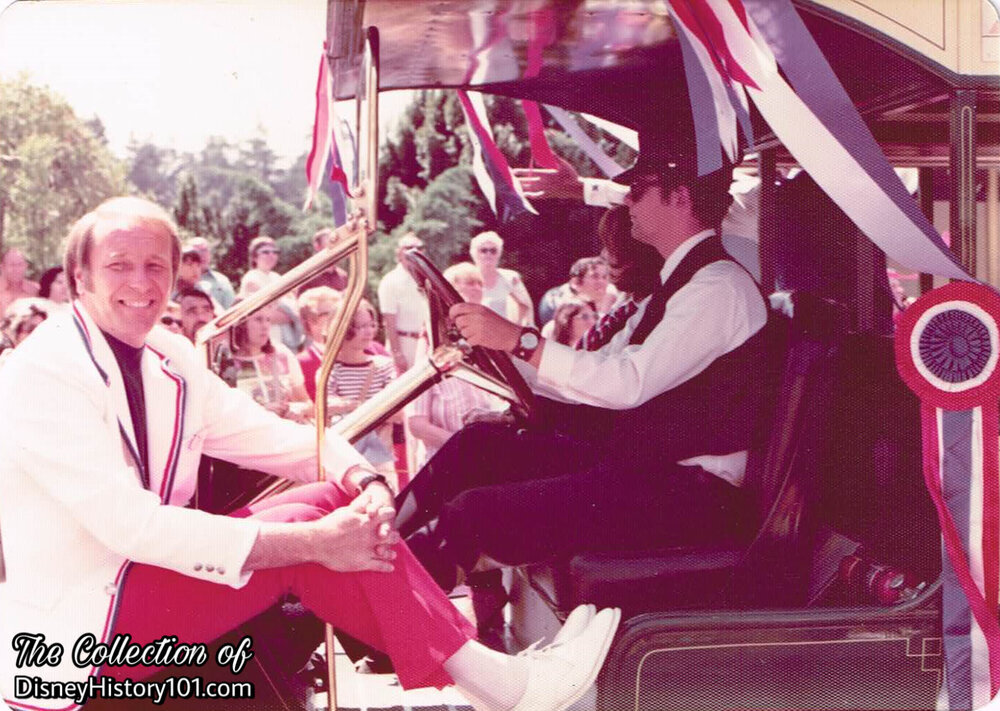
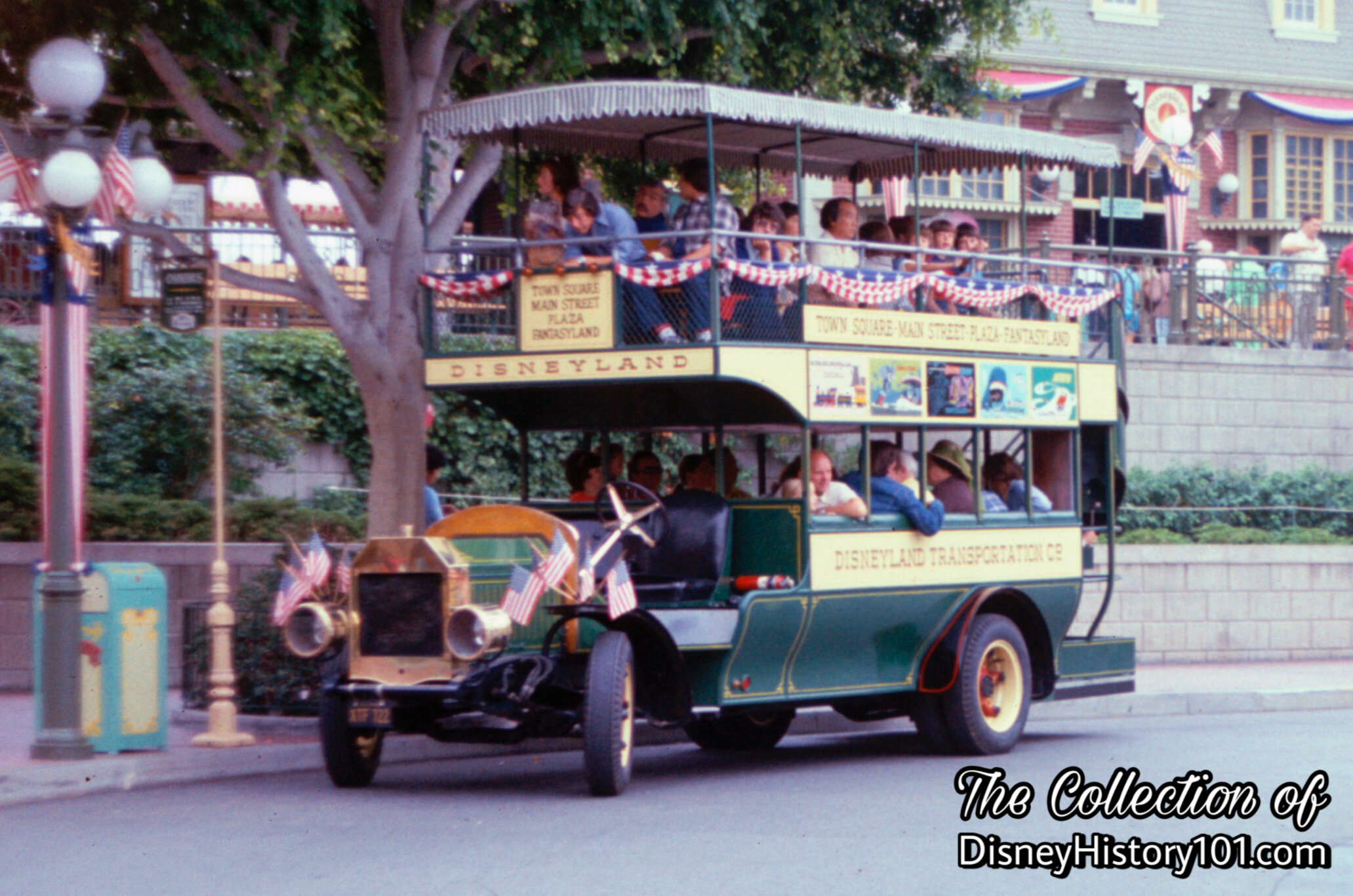
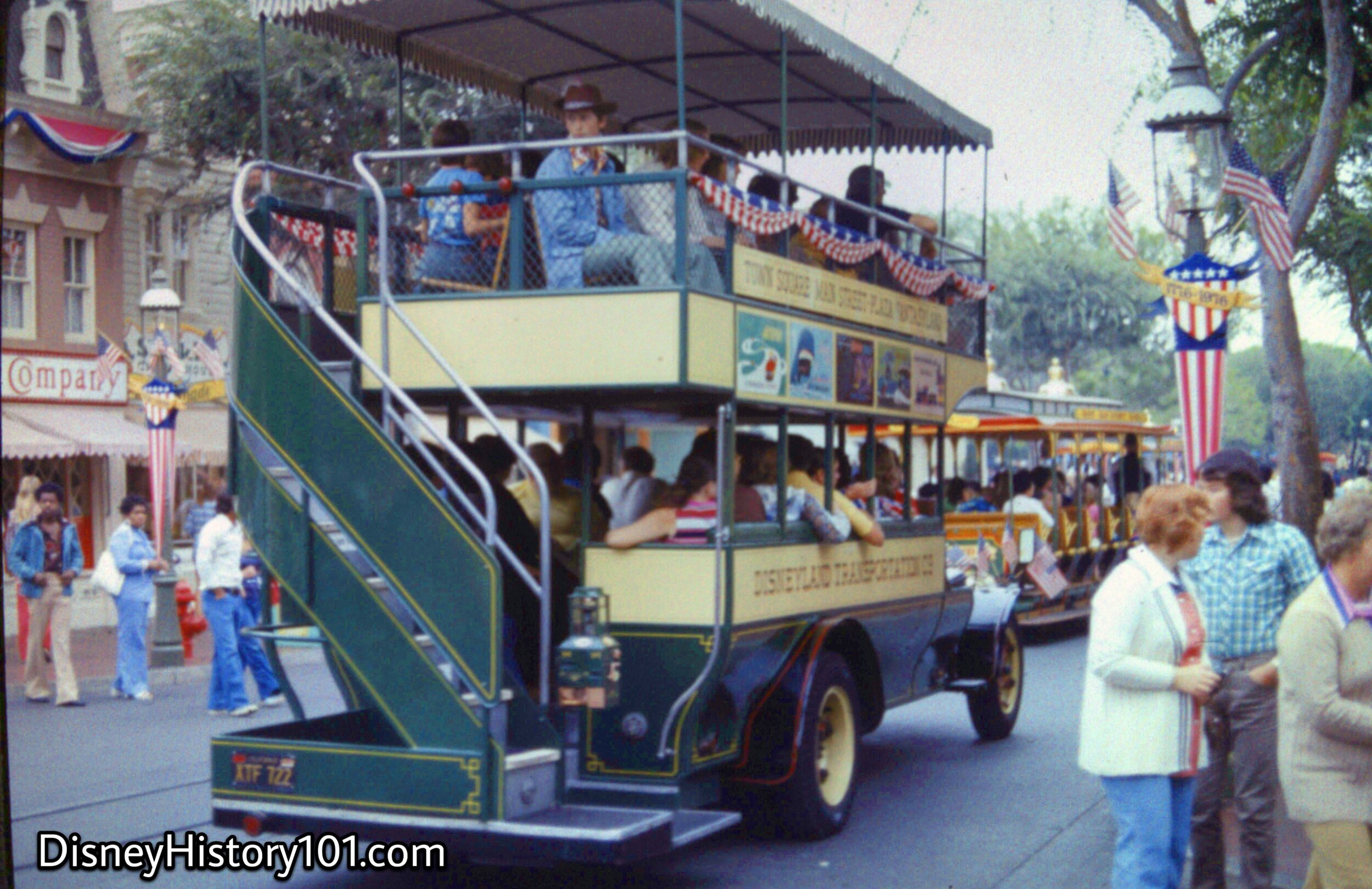
The Omnibus played a role in the American Bicentennial Celebration at Disneyland from 1975 to 1976. The “double-decker” Omnibus was all decked out in red, white, and blue ribbons and bunting in honor of the America on Parade event.
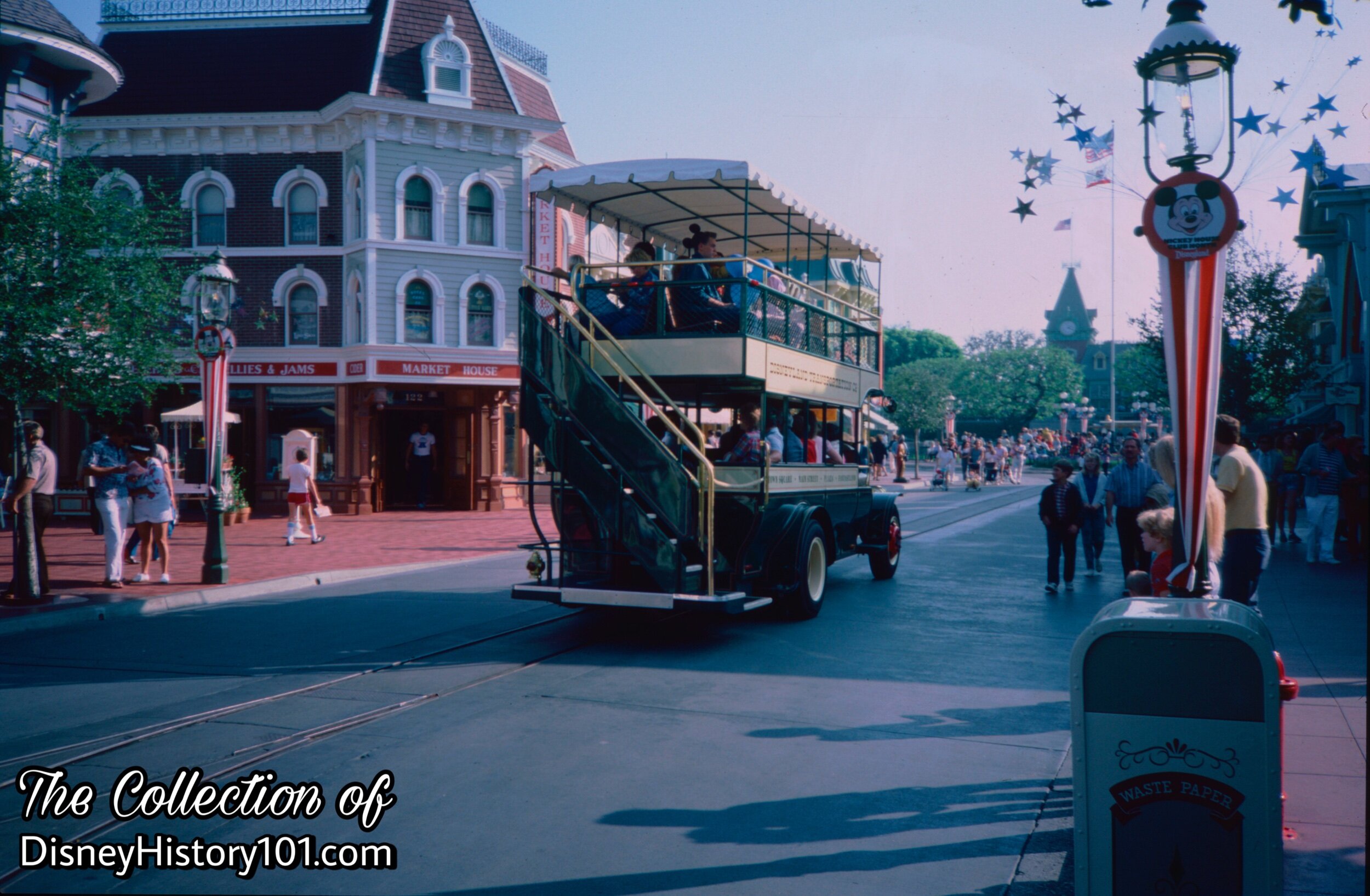
“55er” Dave Bartchard recalled: “I was very impressed when we transferred the vehicles to natural gas. They asked for my opinion about it and I said that I favored the change because I like clean air. The Omnibus was the first to go over to natural gas, then the Jungle boats, and the Motor Boats, Rafts and the Keel Boats followed along. We couldn't do it for the Submarines because there was no place to put the tanks.”
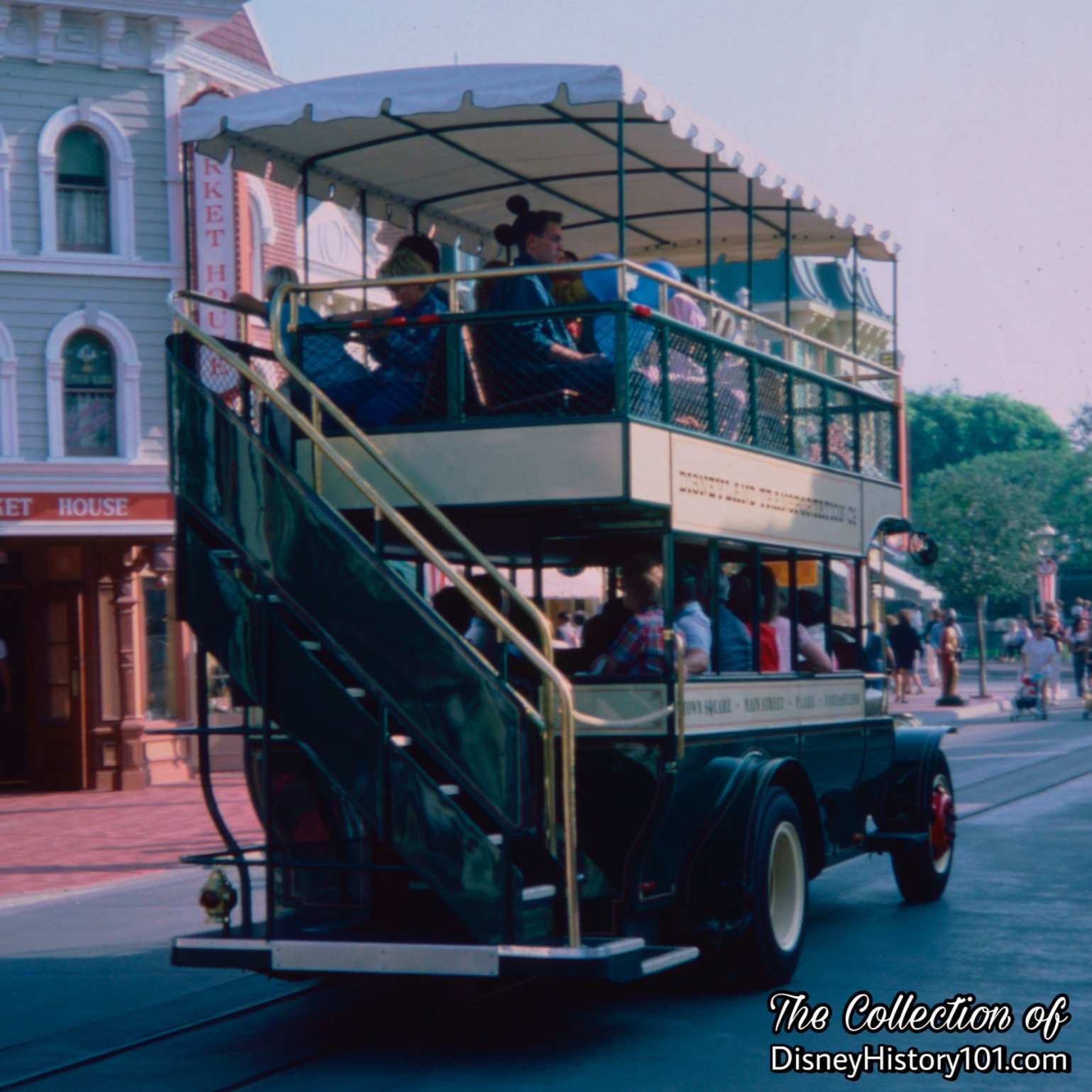
By 1981 Main Street Vehicles were open-air, double-deck busses of the type used in major cities at the beginning of this century. They traveled the Town Square-Plaza route with the driver providing a colorful live-narration along the way. As a result they contributed $24,000 in revenue (of $94,576,000 area sales) for Center Stage at Disneyland.
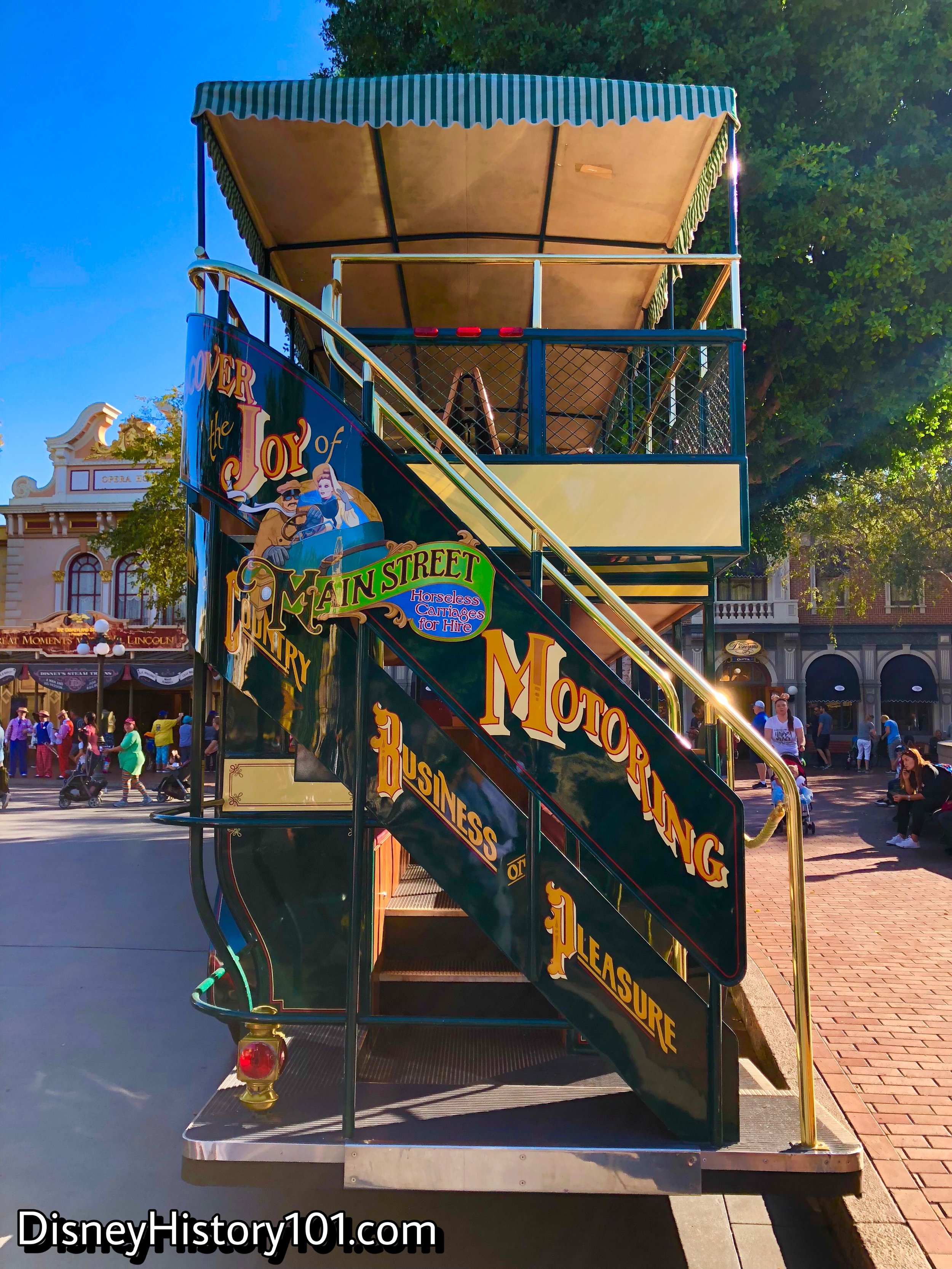
By 1996, the Main Street Vehicles (Fire Engine, Horseless Carriage, Omnibus, Horse-Drawn Streetcars, ‘03 Red, ‘03 Yellow, Double-decker touring bus (5/8-scale), and Horse-powered trolley cars were presented by National Interrent.
In recent years the Omnibus is accounted as part of the Main Street Transportation Co., the fictitious business for the old-fashioned gasoline-powered Main Street vehicles. Disneyland actually looses money on Main Street vehicles, but they are vitally important to the showmanship of Walt’s recreation of Main Street U.S.A. They are operated by the “first impression” and “last impression” representative host of Disneyland.
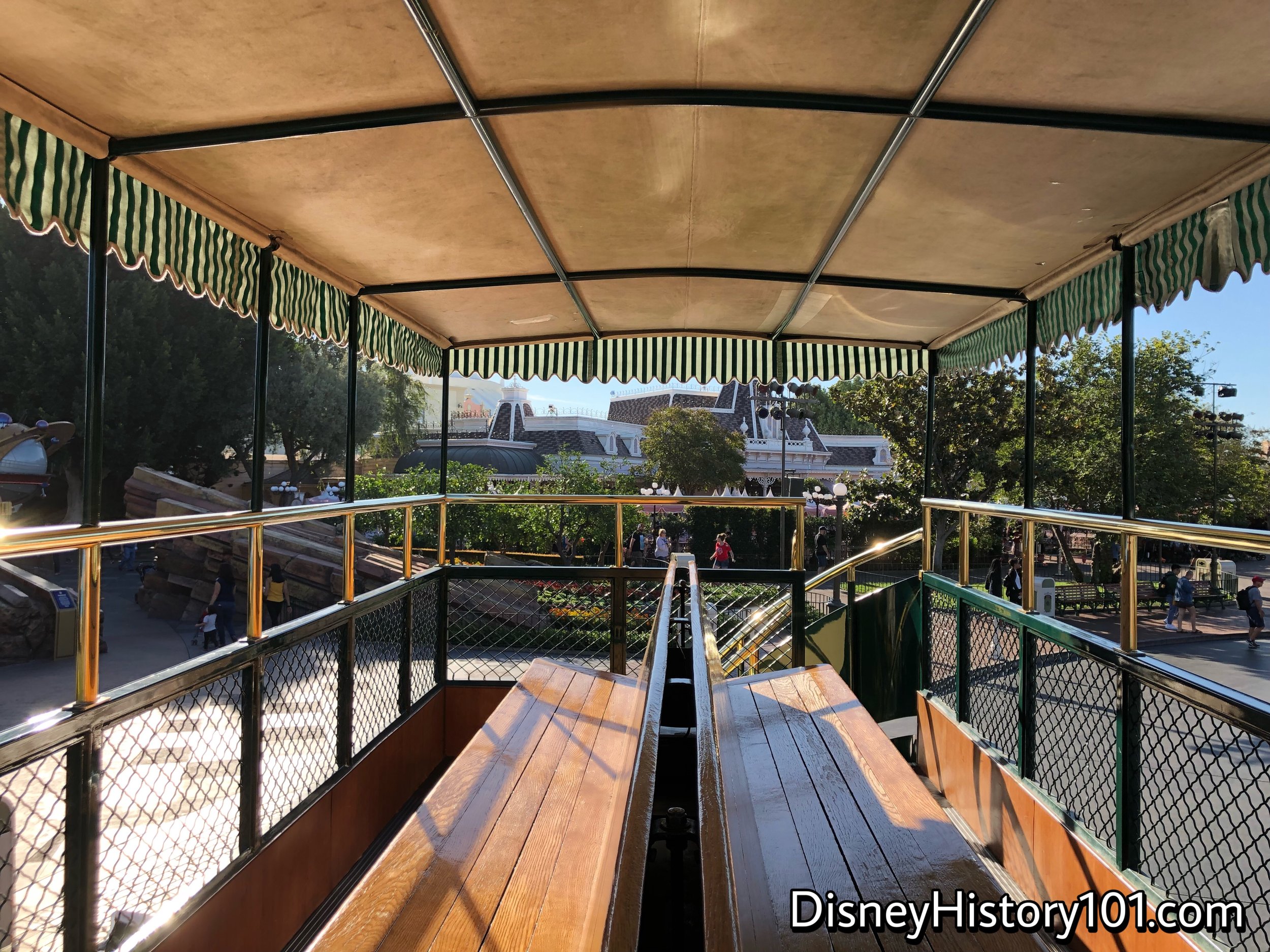
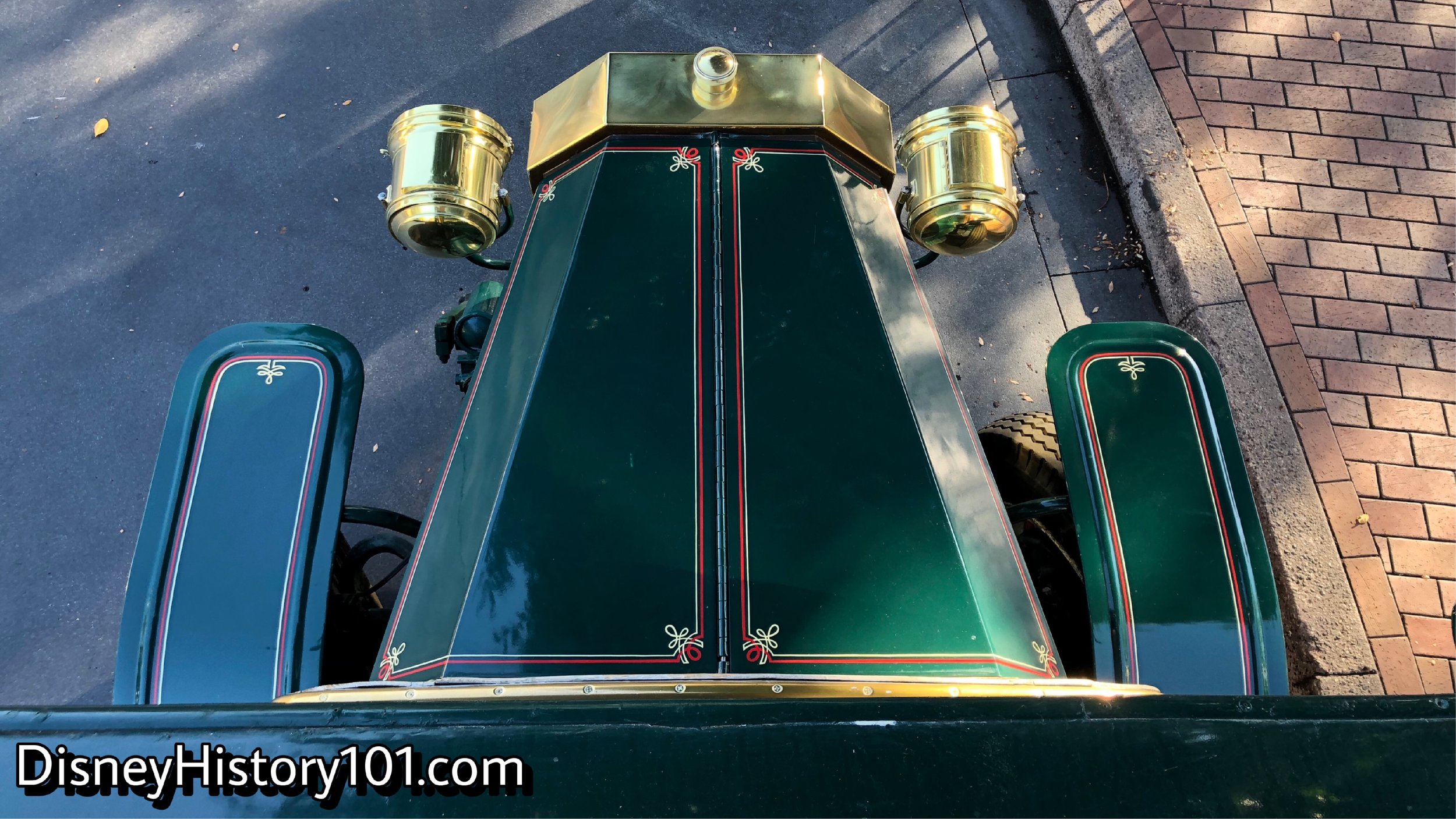
Hosts and Hostesses re-create Main Street, U.S.A. and their show is played up to Walt Disney standards. Hosts show an enthusiastic personality - an appearance, smile, and both outgoing and enthusiastic personality. They wear proper attire, a prescribed wardrobe in good repair and properly worn at all times. Hosts deliver an interesting narration - a good one. They know their facts, state them in an interesting way, and give them with enthusiasm. Hosts have a sparkling and clean appearance, that is essential to Disneyland showmanship. Hosts do their part in keeping their vehicle clean at all times. They are “popcorn picker-uppers”. Their realistic performance is most-important, living their role. The Disneyland Omnibus Host is a conductor or driver at the turn of the century - only much more friendly and courteous!
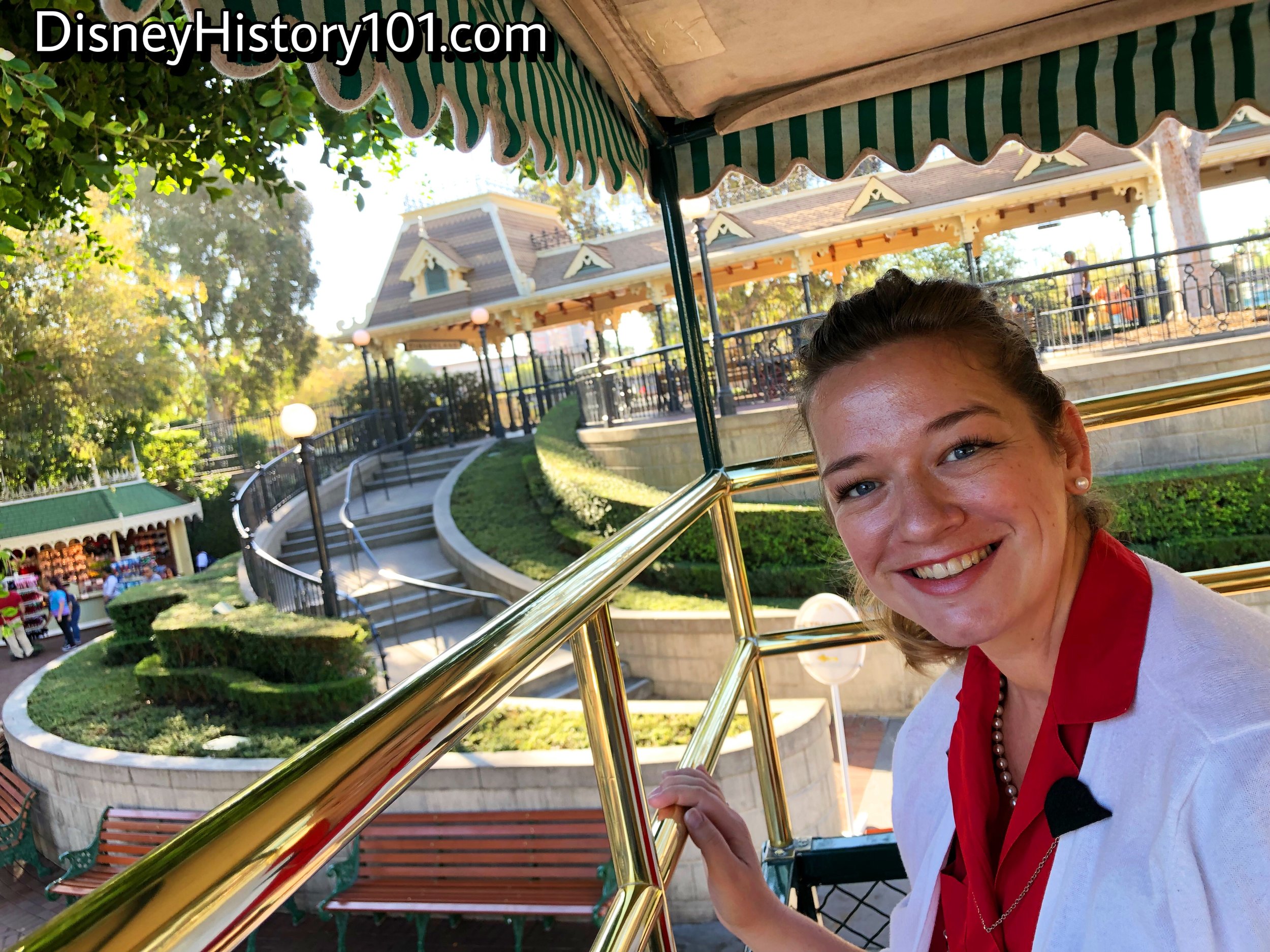
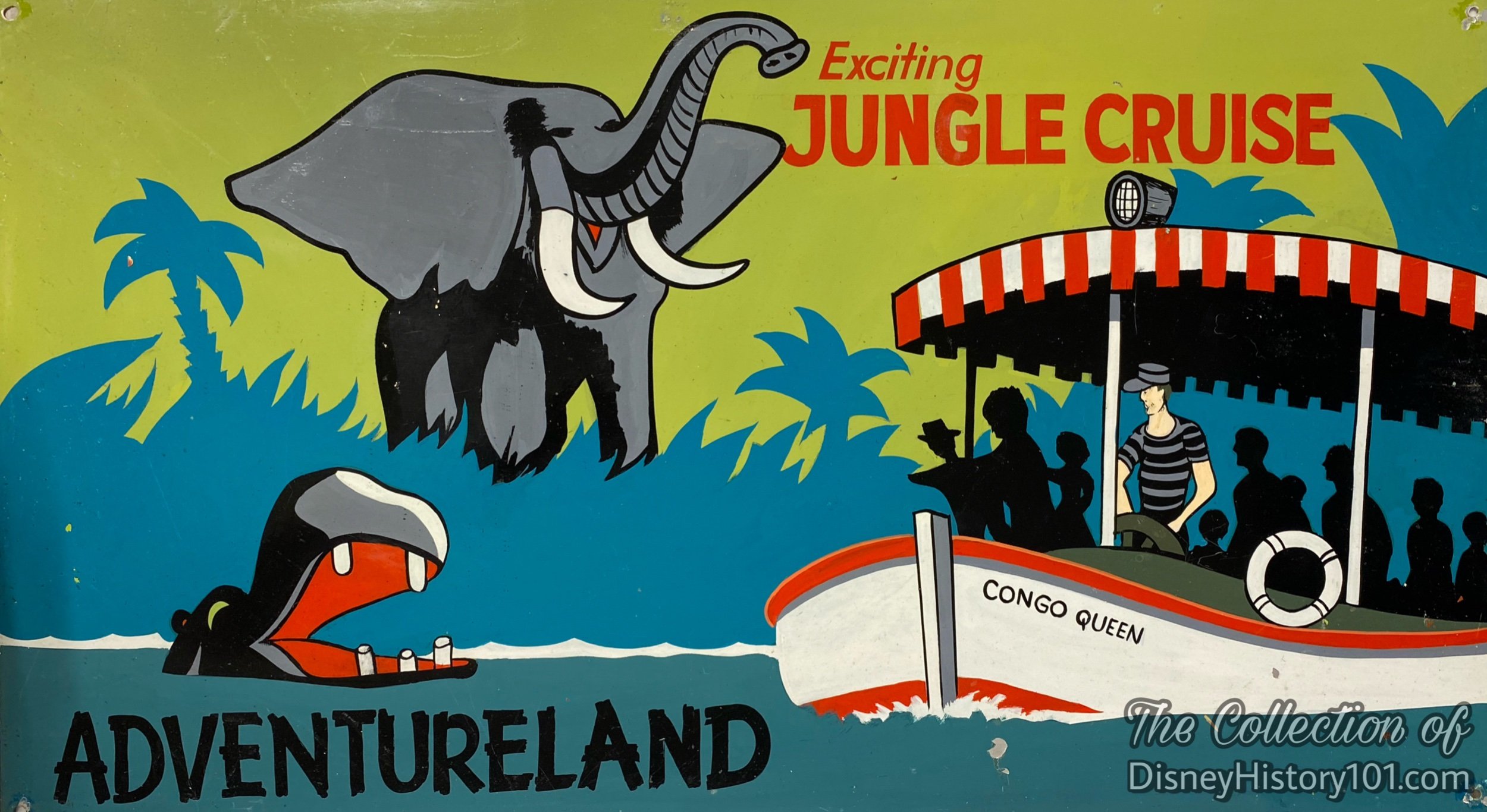
Of course, I saved the best for last - At Disneyland, signs are themed to support the stories with appropriate graphics, colors, fonts, terminology, overall design of the sign, materials (wood, metal, banners, etc.), and verbiage used on the signage. These hand-painted Omnibus panels have surfaced at auction several times, at Van Eaton Galleries and Heritage Auctions.
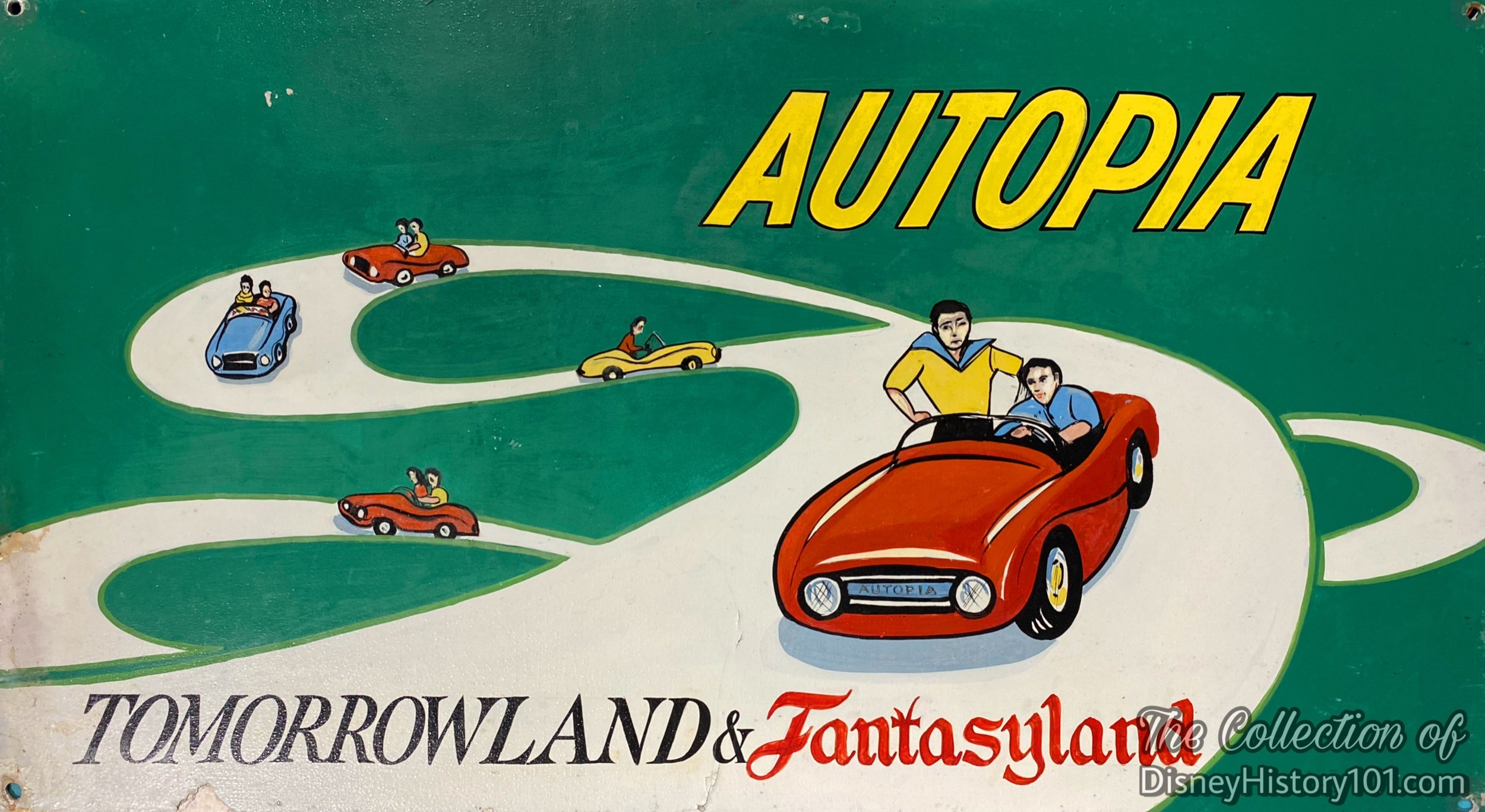
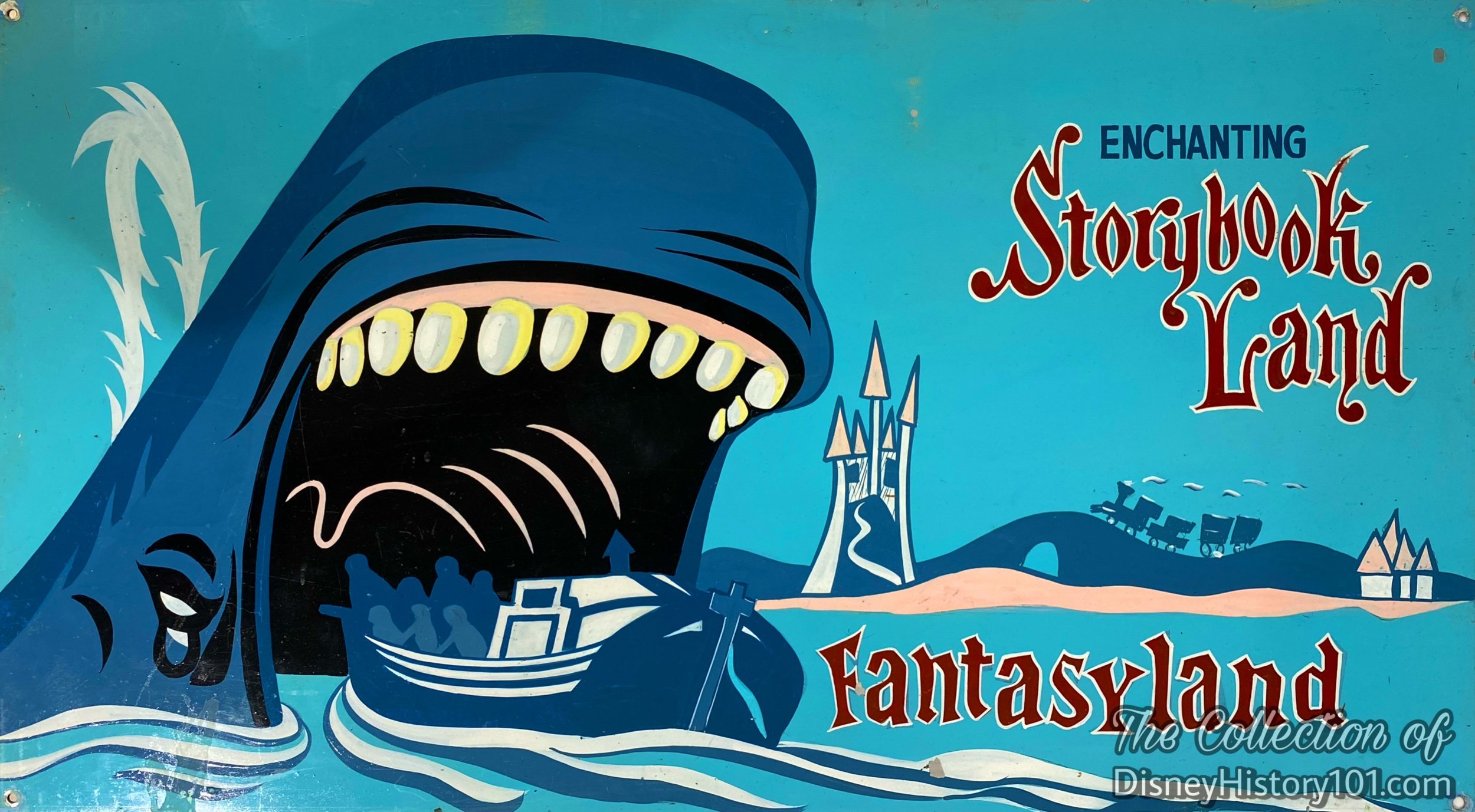

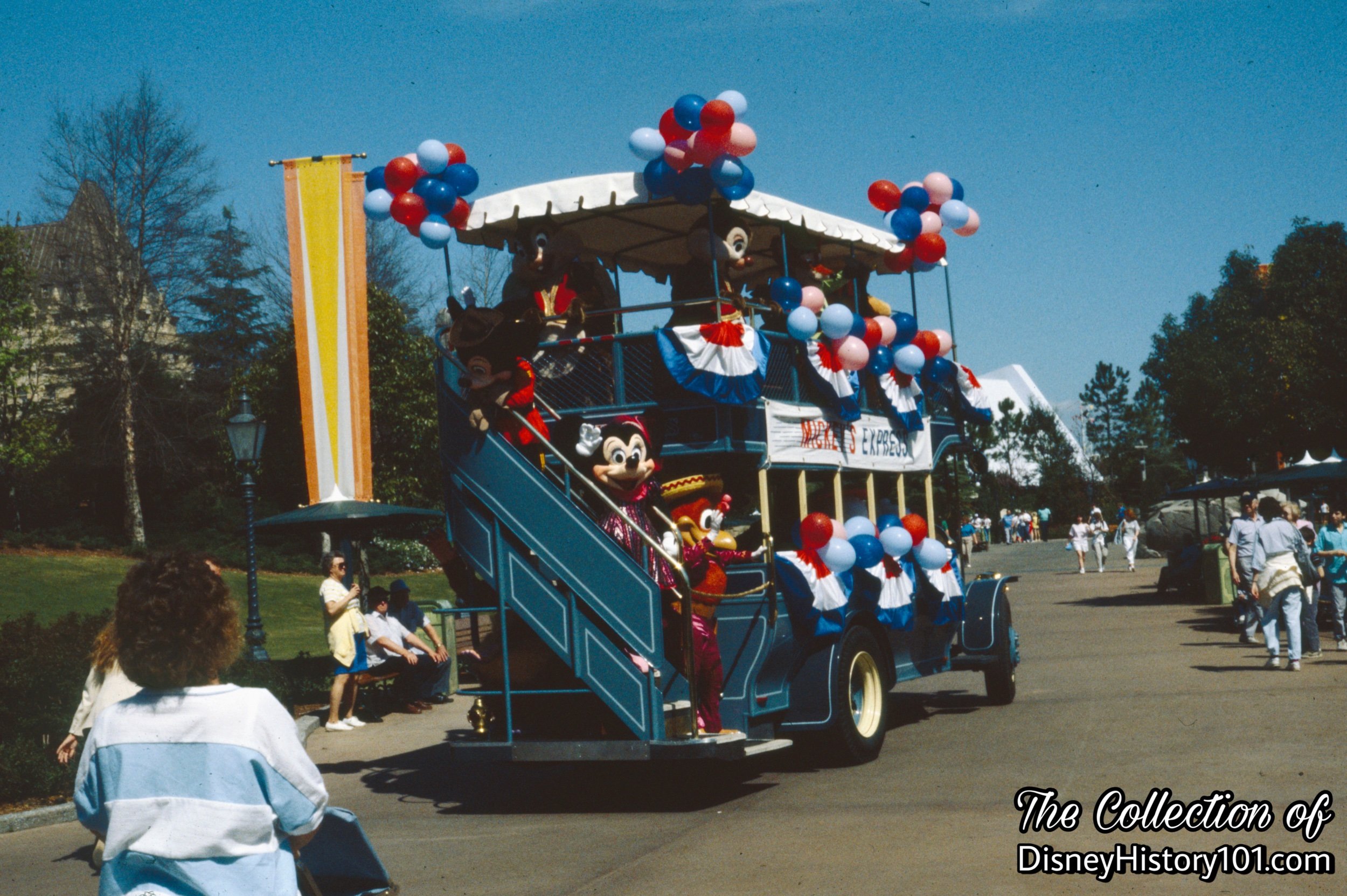
The Omnibus had an immediate legacy and may look familiar to anyone who has ever been to the Magic Kingdom or EPCOT Center in Florida. In 1971, guests could get an overview of the Magic Kingdom’s Main Street aboard an old-fashioned double-decker bus. In 1982, Bob Gurr was asked to oversee a fleet of new Omnibuses. Bob Gurr’s 1956 engineering drawings were used for the buses built for Epcot Center in 1982. The two Disneyland buses had their bodies removed from the original 1956 and 1957 International Harvester chassis and mounted on 1982 Chevrolet truck chassis.
By 1984, both Disneyland Omnibuses had been sent to Walt Disney World and Bob Gurr’s design was swiftly utilized to provide Guests a colorful mode of transportation around the World Showcase. Mickey’s Express also transported Characters around Epcot. By c.2007, Guests May recall “Disney Characters on Holiday” (DCOH), a group of Characters that performed in several locations in Epcot, entering and exiting on a European double-decker bus.
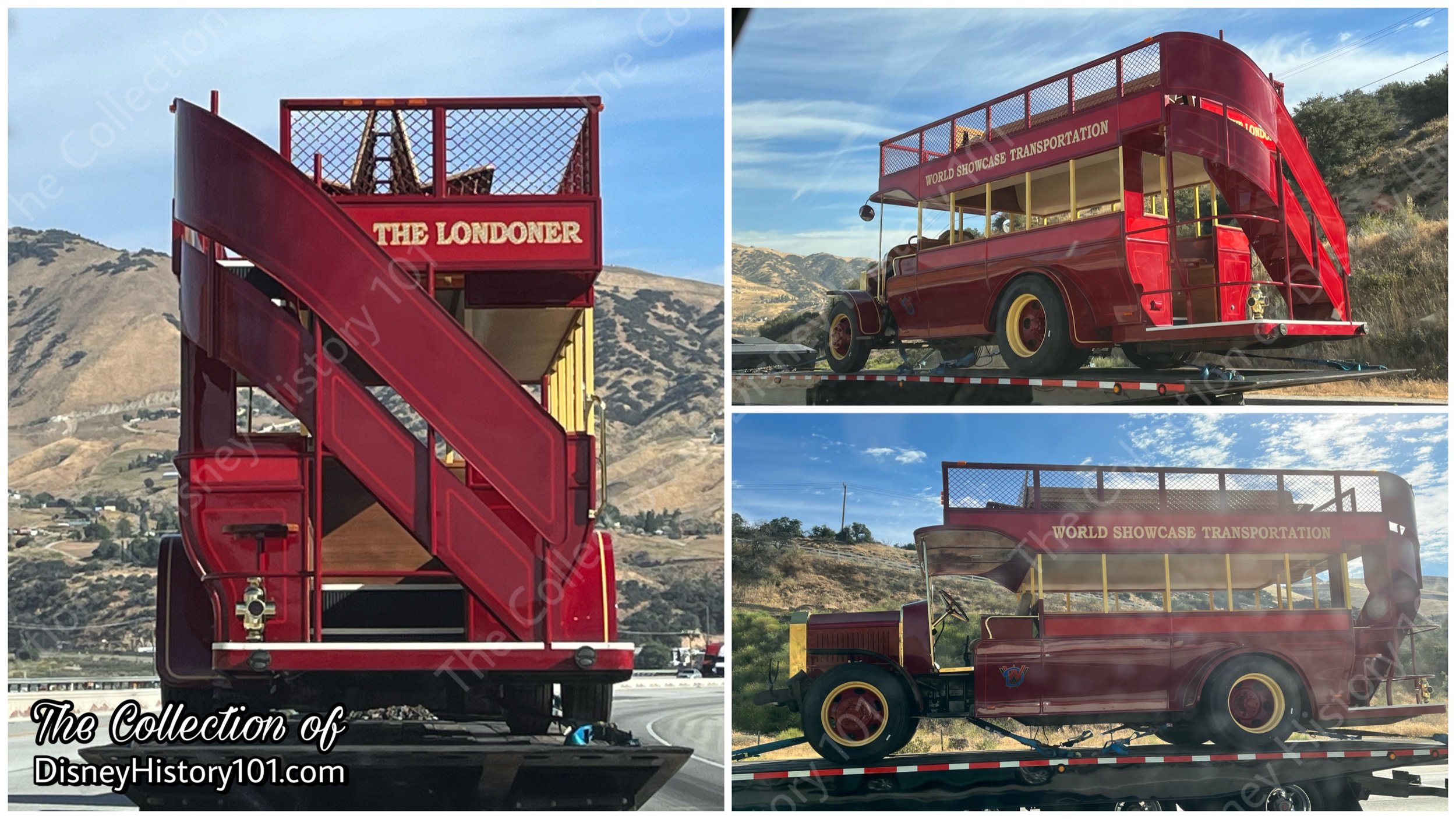
The World Showcase Omnibuses have turned up in many locations - ranging from downtown Kissimmee to the Volo Auto Museum in Illinois, and even New Jersey, and New York. The Londoner Omnibus was one of the longest operating Omnibuses at Walt Disney World. After being decommissioned during the 2000s, it was purchased in Central Florida by Robin and Brook Lopez of the Milwaukee Bucks Basketball Team. The bus was moved to Southern California and restored to its 1982 appearance. While driving on the 5 Freeway in California (outside of Los Angeles) we serendipitously passed the Londoner Omnibus headed to Fresno for maintenance.
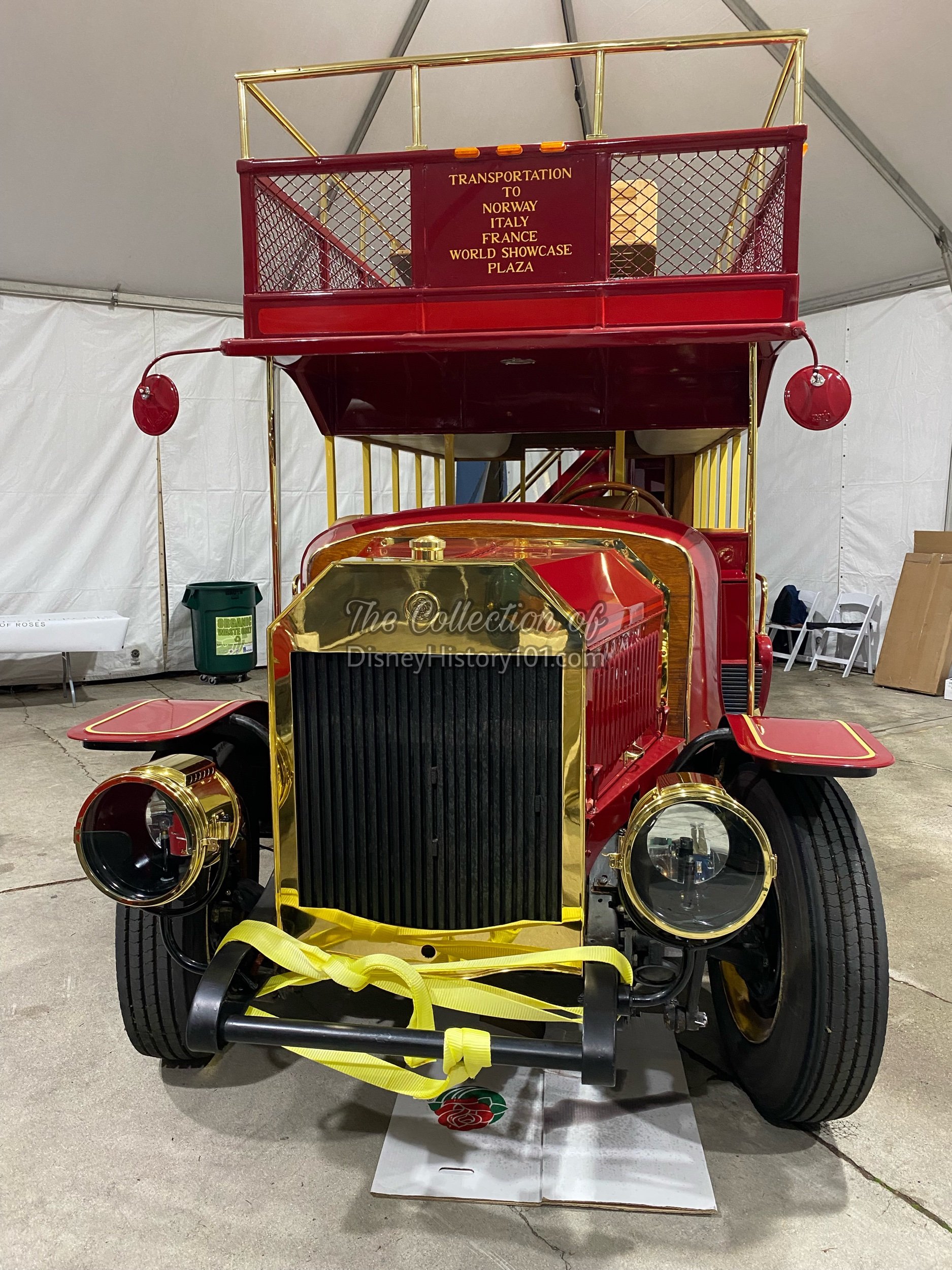
A few months later, we saw that same Omnibus lined up to appear in the 2024 Tournament of Roses Parade in Pasadena, California. It was used to transport the Tournament of Roses President Aghajanian.
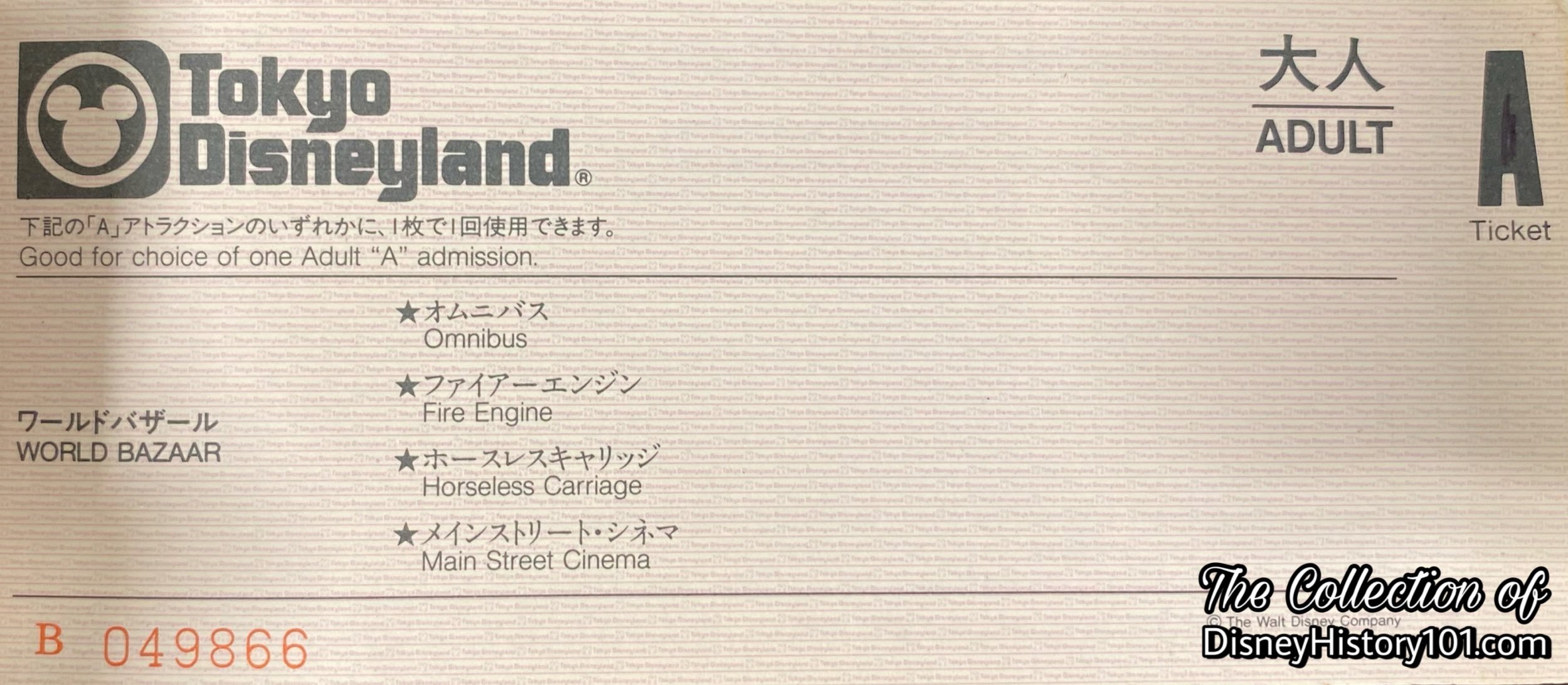
The Omnibus continued to have a legacy on other continents, at Tokyo Disneyland. By the spring of 2003, the Main Street Vehicle was also included among the concepts produced for Hong Kong Disneyland by Walt Disney Imagineering.
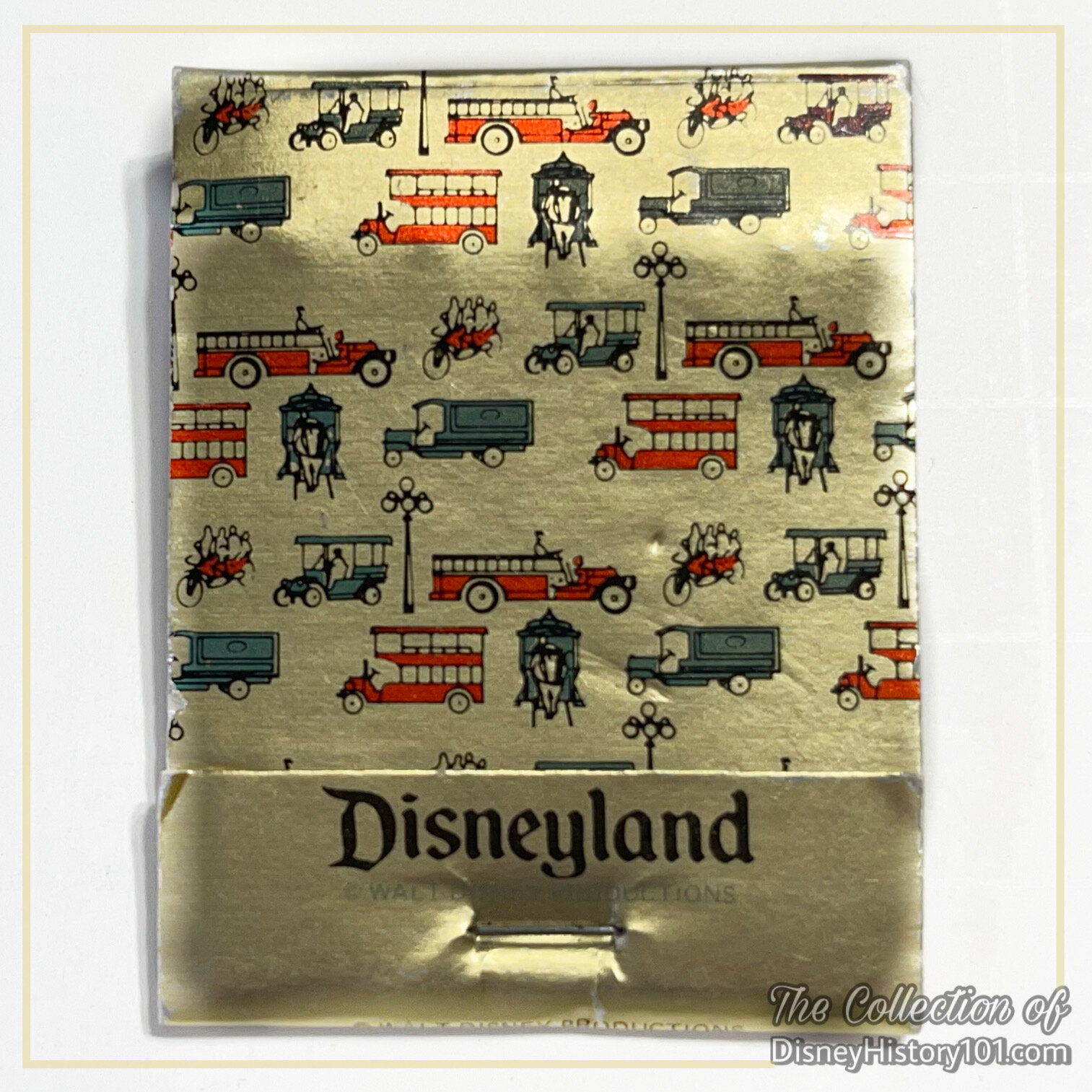
The Omnibus has appeared as the subject of occasional Disneyland souvenir merchandise. By far, this is one of my favorite - a complimentary matchbook covered with iconic Main Street vehicles. How many can you identify?
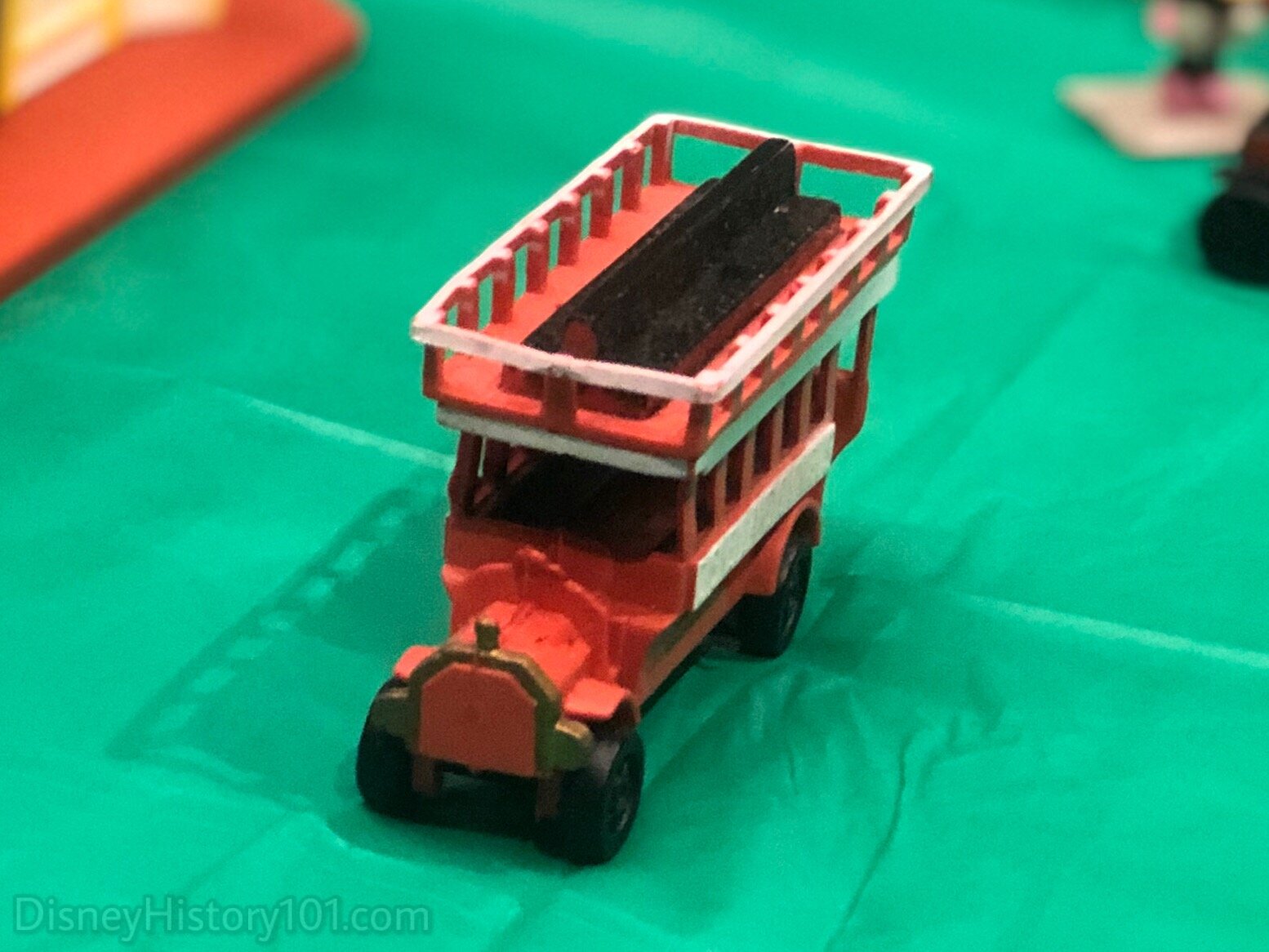
You may have heard of the “yellow and green Omnibus,” but have you ever heard of the red Omnibus?
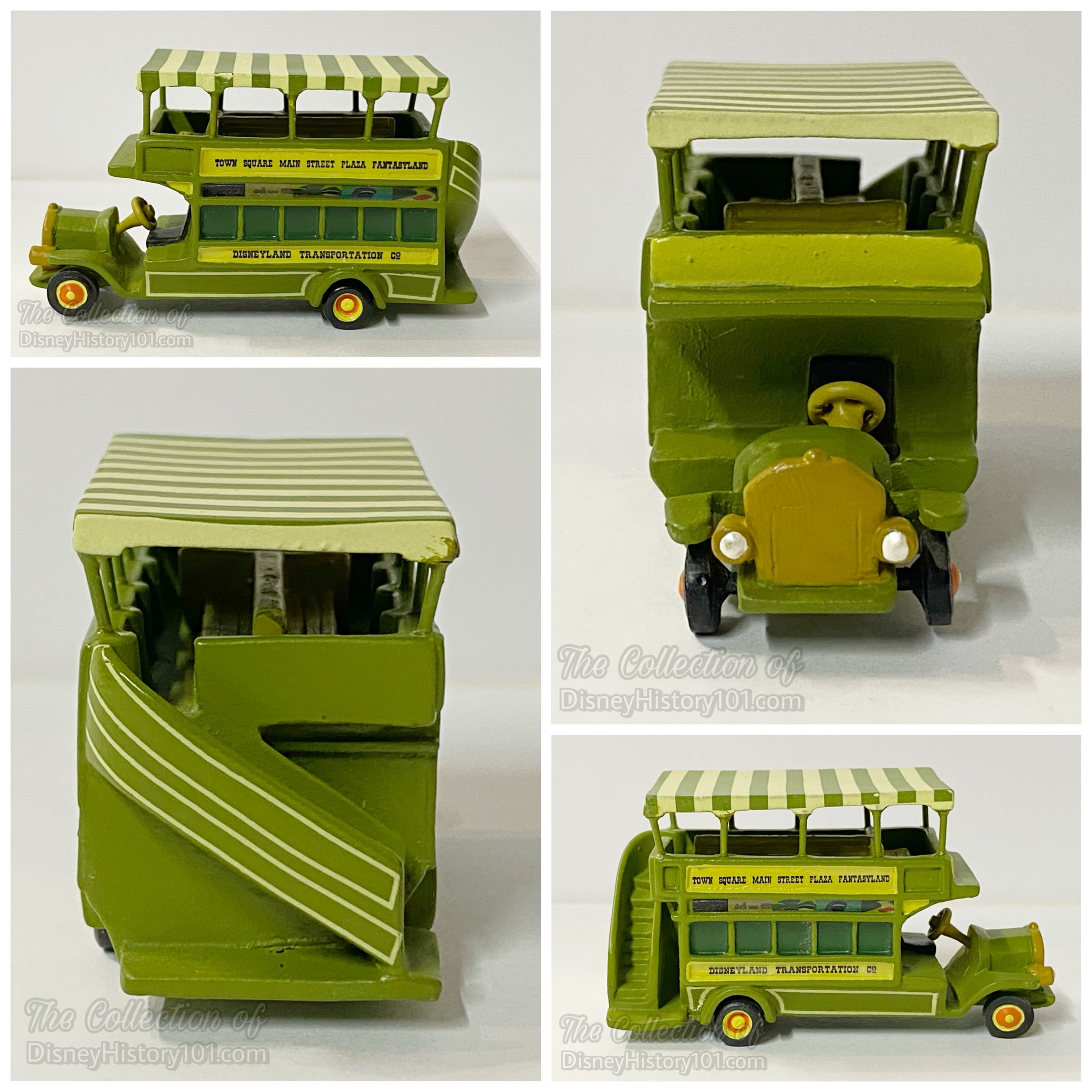
The timeless Omnibus, continues to be the subject of artwork and other merchandise made available for purchase. One of the cutest is this adorable Disneyland 50th Anniversary Pewter Figure designed by Kevin Kidney & Jody Daily.

One of my personal favorites is this loyal Disneyland 50th Anniversary limited edition replica designed by Kevin Kidney & Jody Daily.
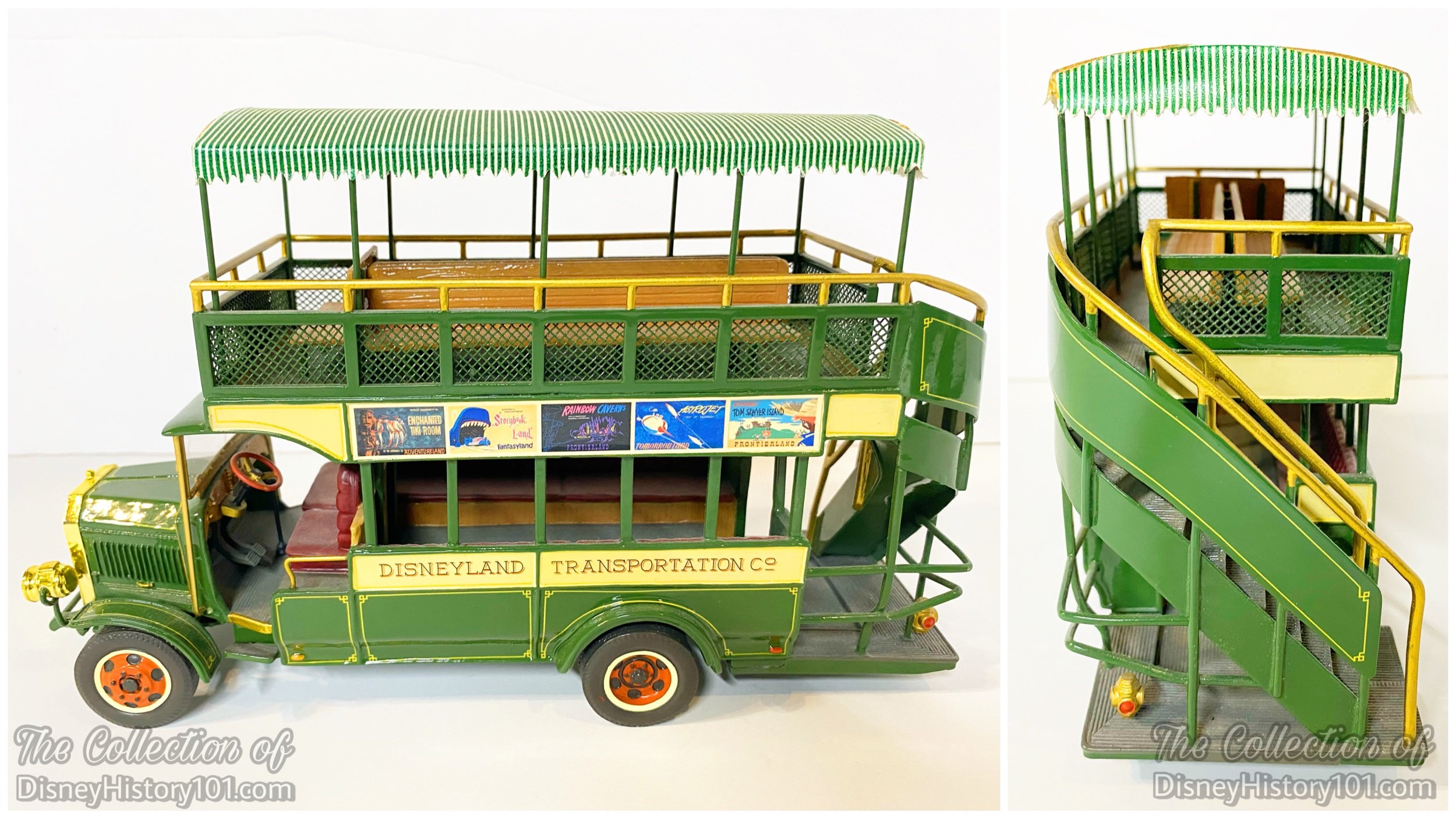
POP CORN (& CRETORS)
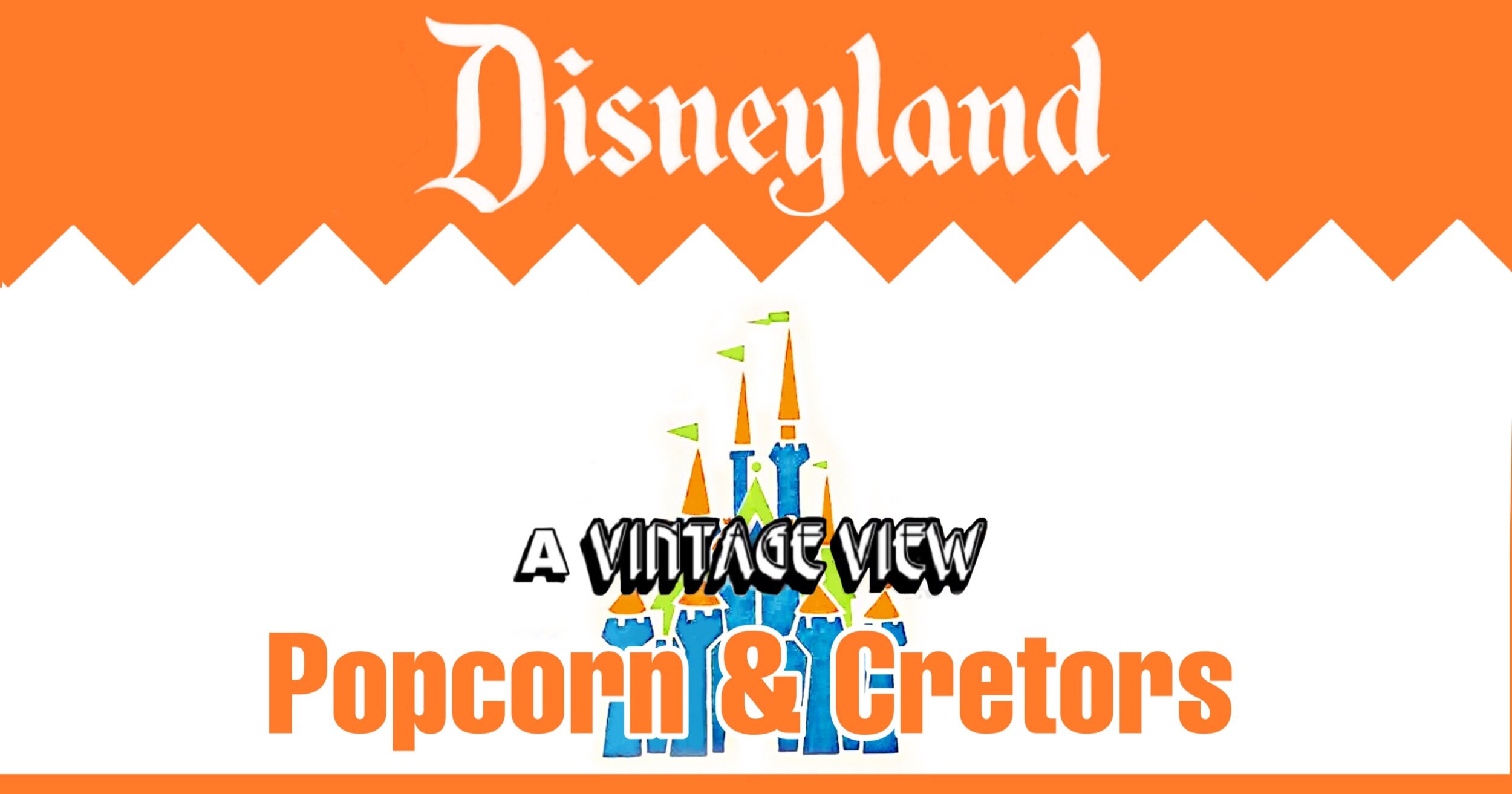
“Prologue”
Popcorn has been around almost as long as our country has been around. But even before that, the First Peoples of this land have been eating popcorn for over 5000 years!
Popping corn has a small amount of moisture which is caught inside the hard shell of the kernel as it grows. When heated, this moisture vaporizes to steam, exerting a tremendous amount of pressure, and “explodes” the kernel. In addition, there are two colors of popping corn . . . yellow and white. Of these, the yellow variety was preferred by gourmets for its flavor!
Today, popcorn is sold as the number one treat in over 99% of all movie theaters! Around Disneyland, popcorn cretors are a common sight in each land, the smell of popcorn fills the air, and the warm snack continues to be very popular with Guests.
“Cretors”
Many have asked, ‘What exactly is a Cretor?’, so I would like to address this inquiry first. The word takes its origin from the C. Cretors & Company - the 1855 company that first manufactured the old-fashioned carts and “doll” vendors! It is no surprise that the old-fashioned Cretor (Popcorn Cart) vendor has been synonymous with the smell of freshly-popped kernels in Disneyland since 1955! The gay red Cretors were imported from Germany, and rehabilitated (with the help of Ferro Sheet Metal). The final products can be seen on Dateline Disneyland (aired July 17, 1955), and one can readily be seen on East Center Street, in some footage of “Disneyland, U.S.A.” (a “People and Places” feature film, released in the U.S. on December 20, 1956 through Buena Vista Film Distribution Company). At the same time, A Complete Guide to Disneyland (c. 1956) tantalized Guests with the following advertisement : “Eager adventurers with hearty appetites find Disneyland’s popcorn vendors and their shiny red wagons irresistible.”
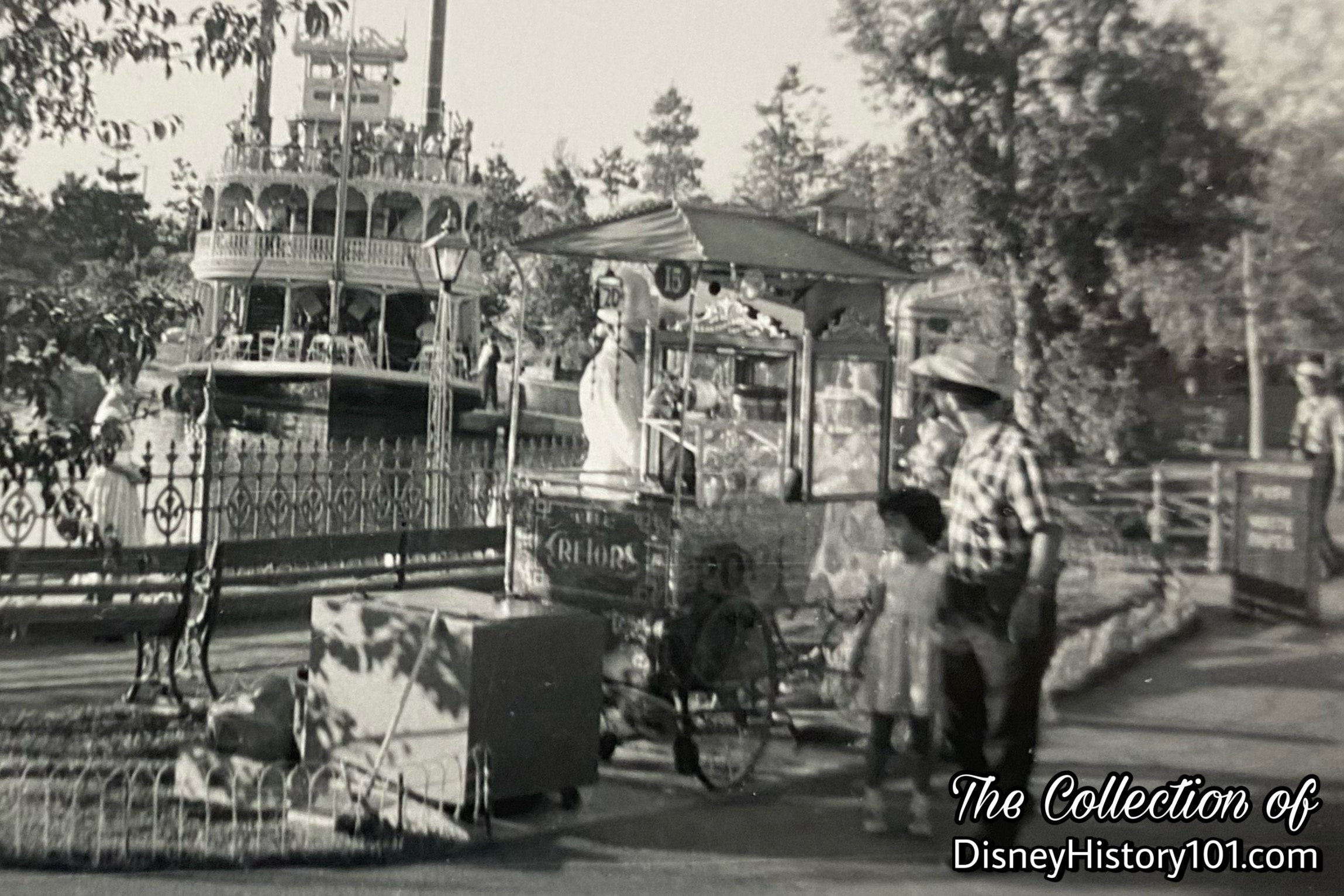
By July of 1954, Raul Grizante of Disneyland, Inc. was overseeing food philosophy, area & location, food specialties, and beverages for Disneyland.
Through the 1950s and early 1960s, the Popcorn Wagons were operated by UPT Concessions. These offered popcorn and peanuts to Disneyland Audiences in multiple On Stage locations (like in Town Square and on Center Street) during peak seasons.

By the time that the previous Vintage View was captured, the Cretors (operated by UPT Concessions) also offered a selection of Fritos brand snacks (including Fritos brand peanuts). According to The Story of Walt Disney by Diane Disney as told to Pete Martin, peanuts were sold without shells because they had potential to dirty up the sidewalks at Disneyland.
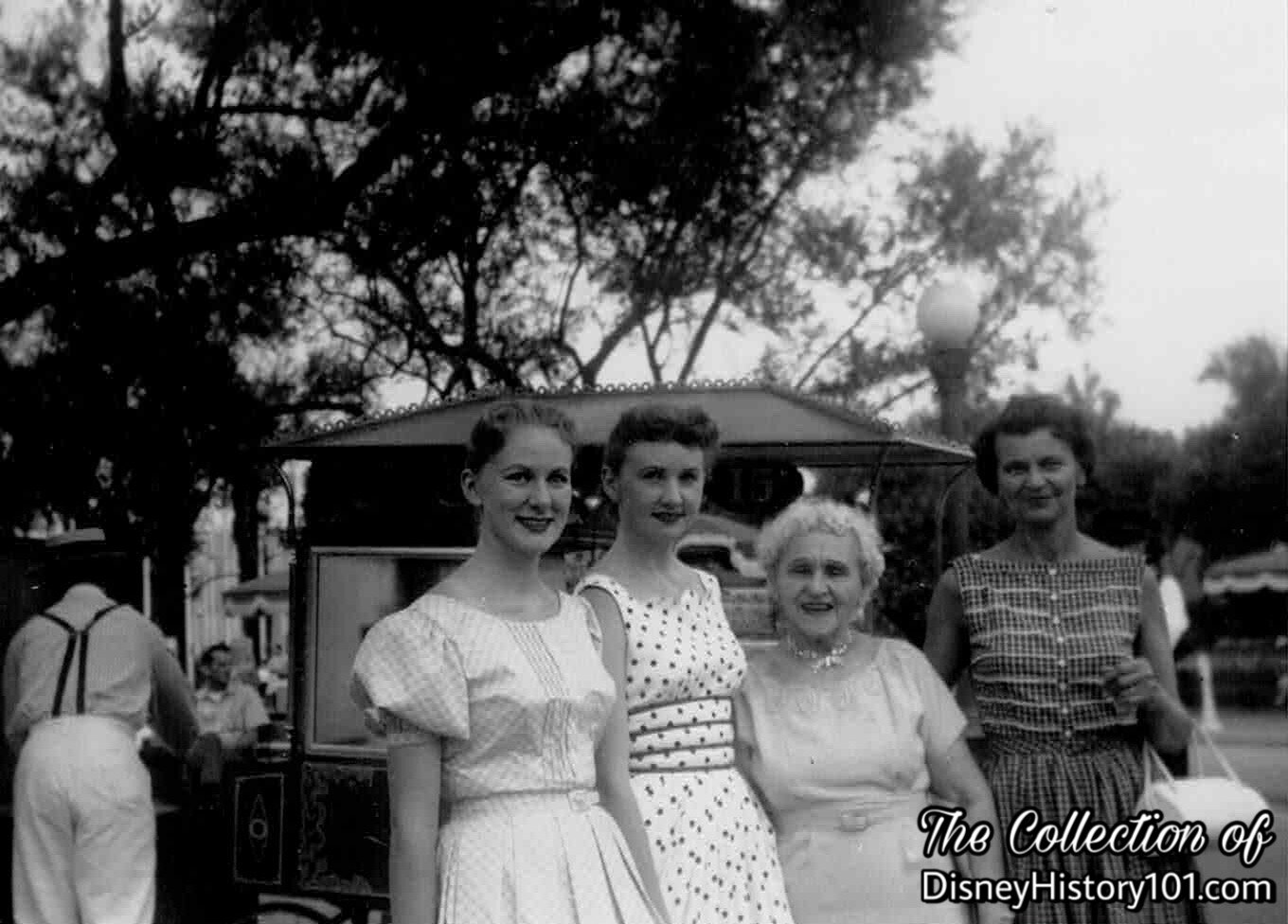
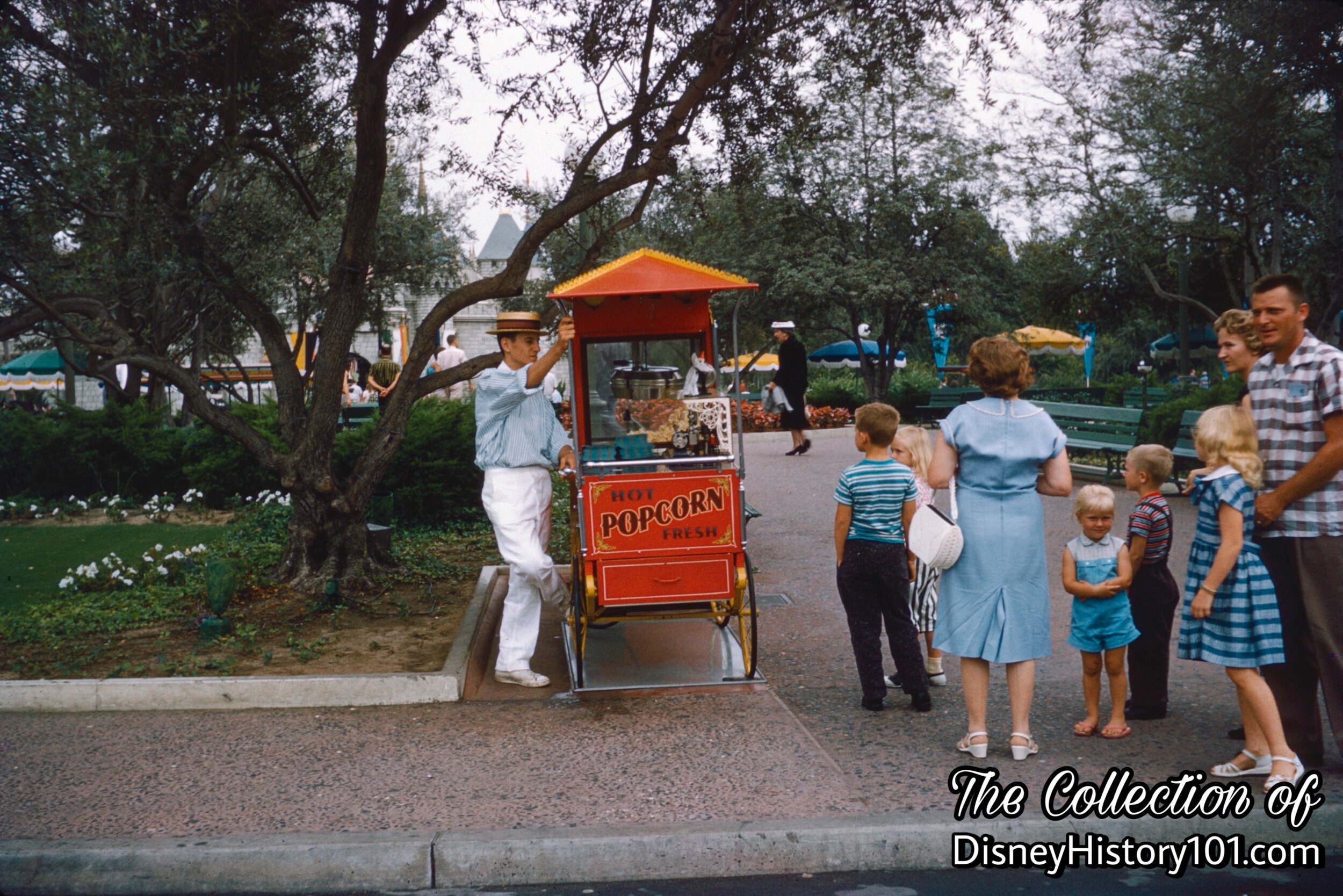
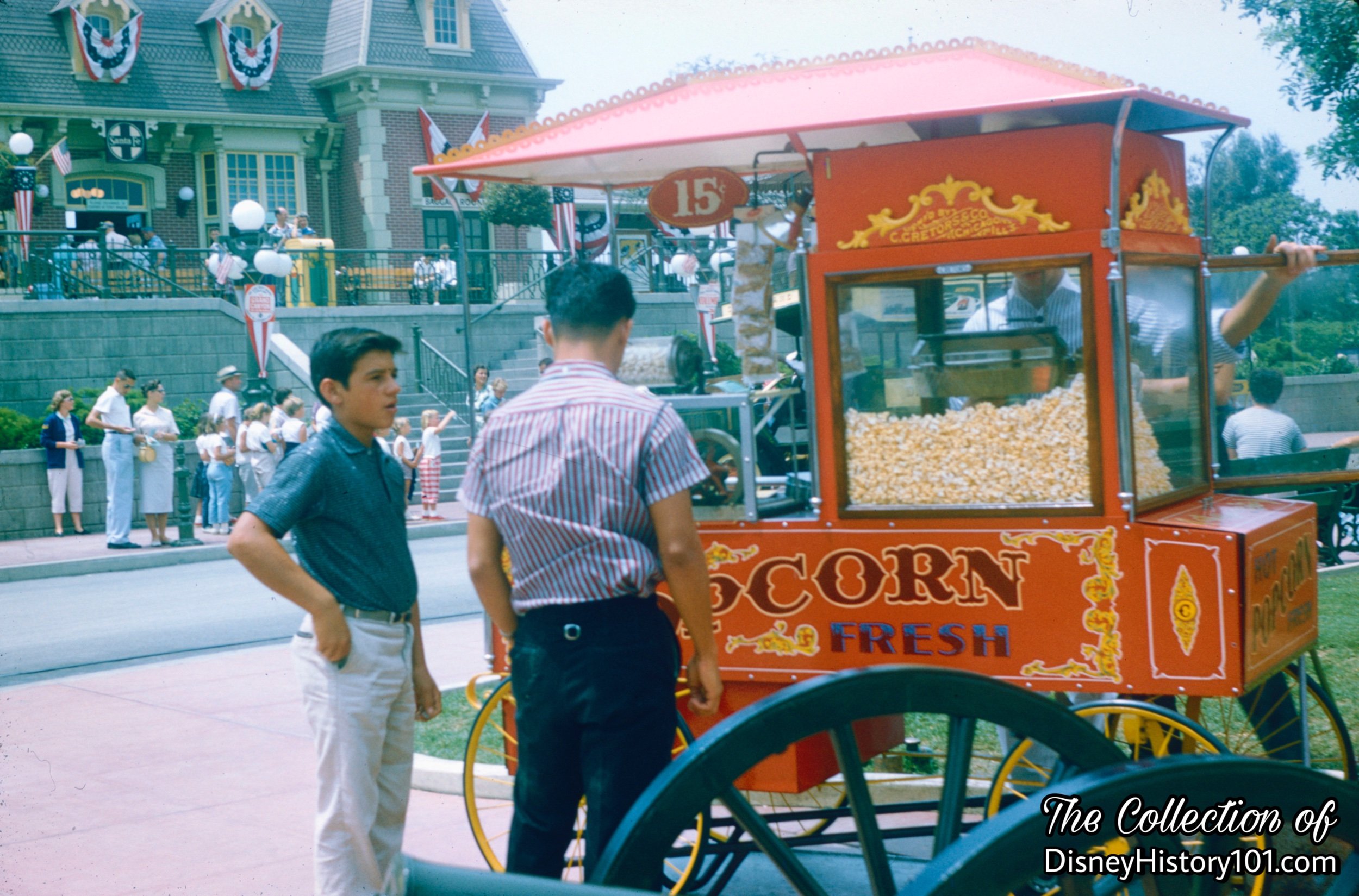
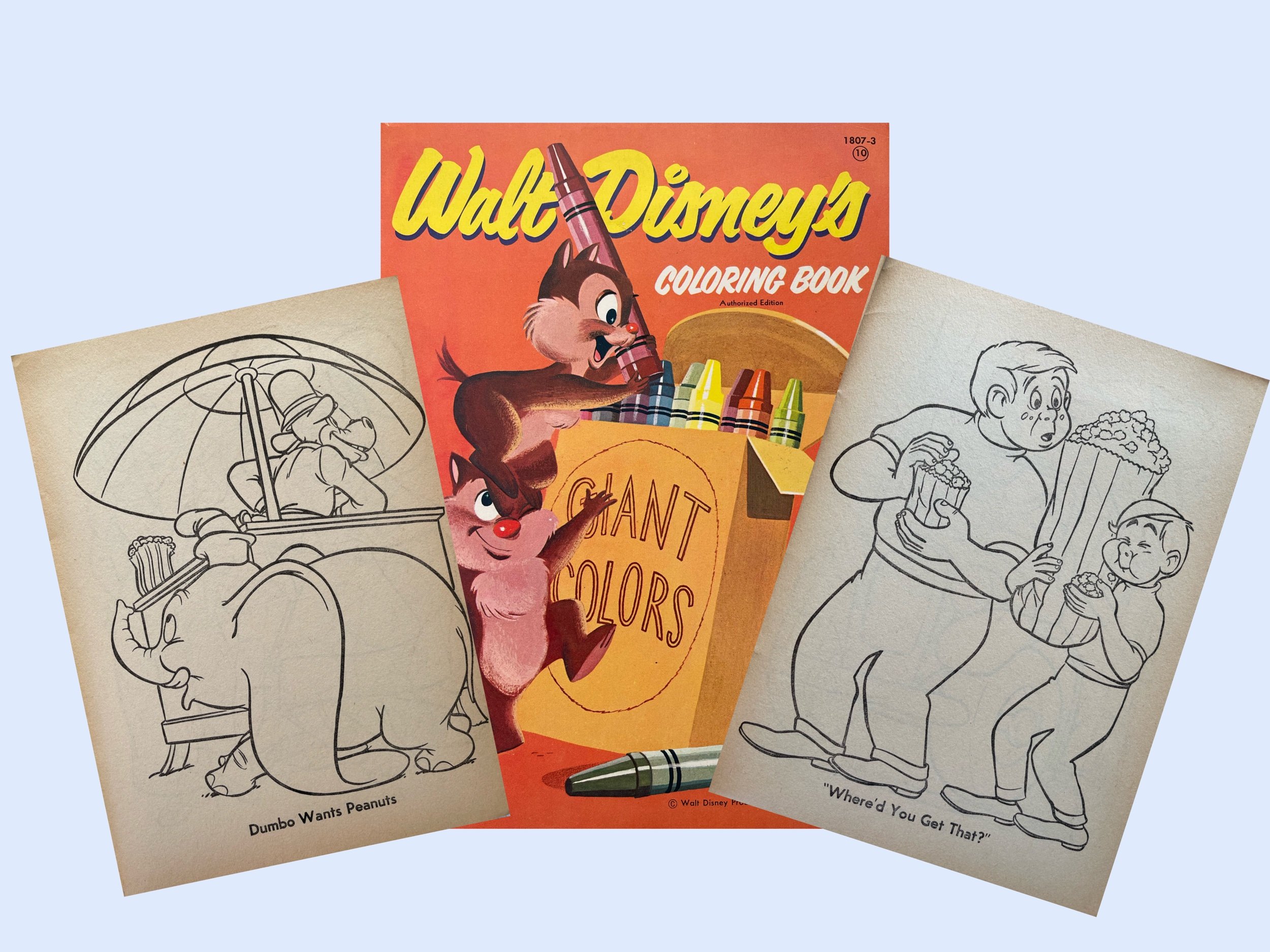
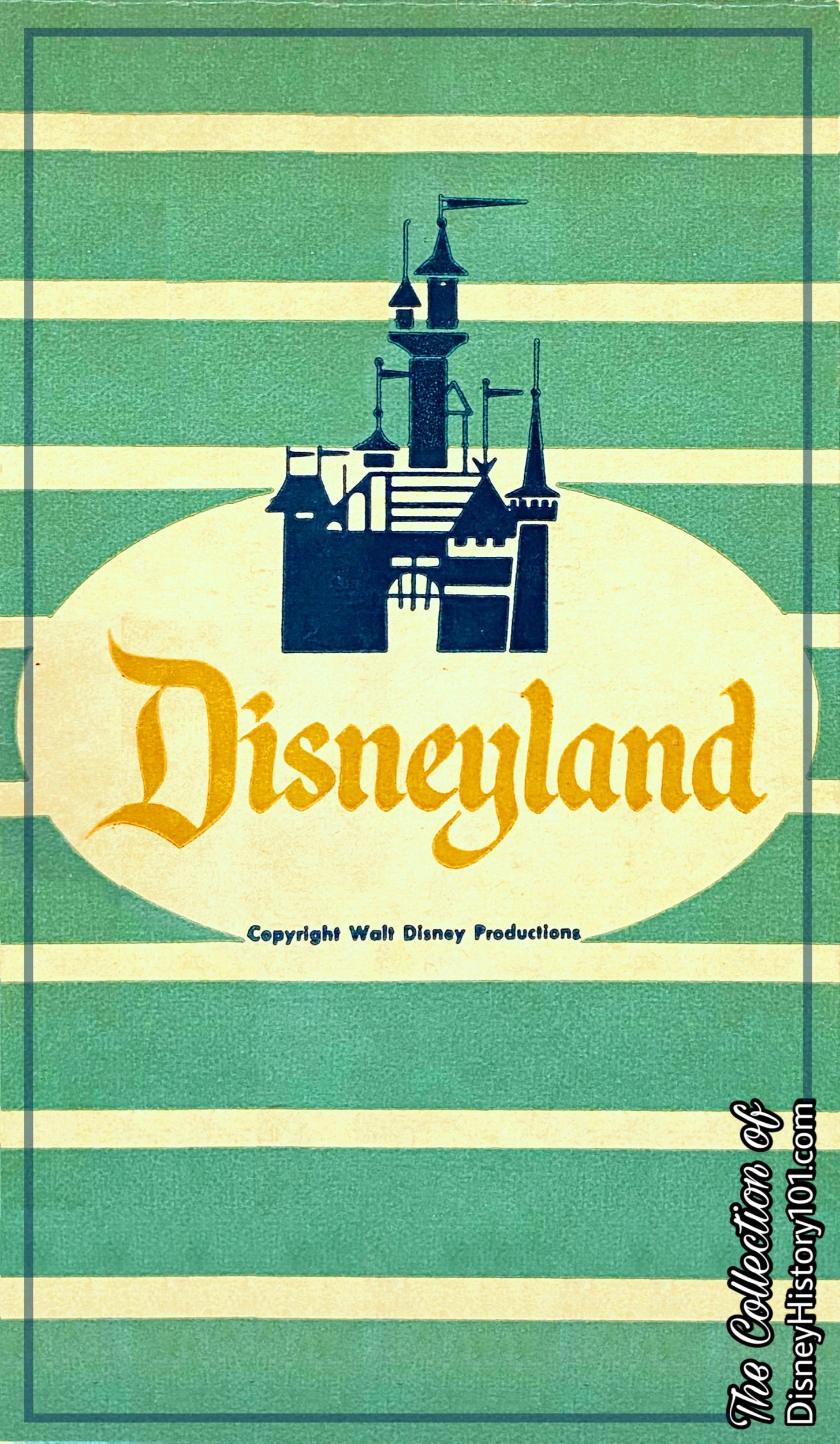
Don’t be fooled by those coloring book illustrations. Until about 1960, Disneyland Popcorn was served in rectangular boxes.
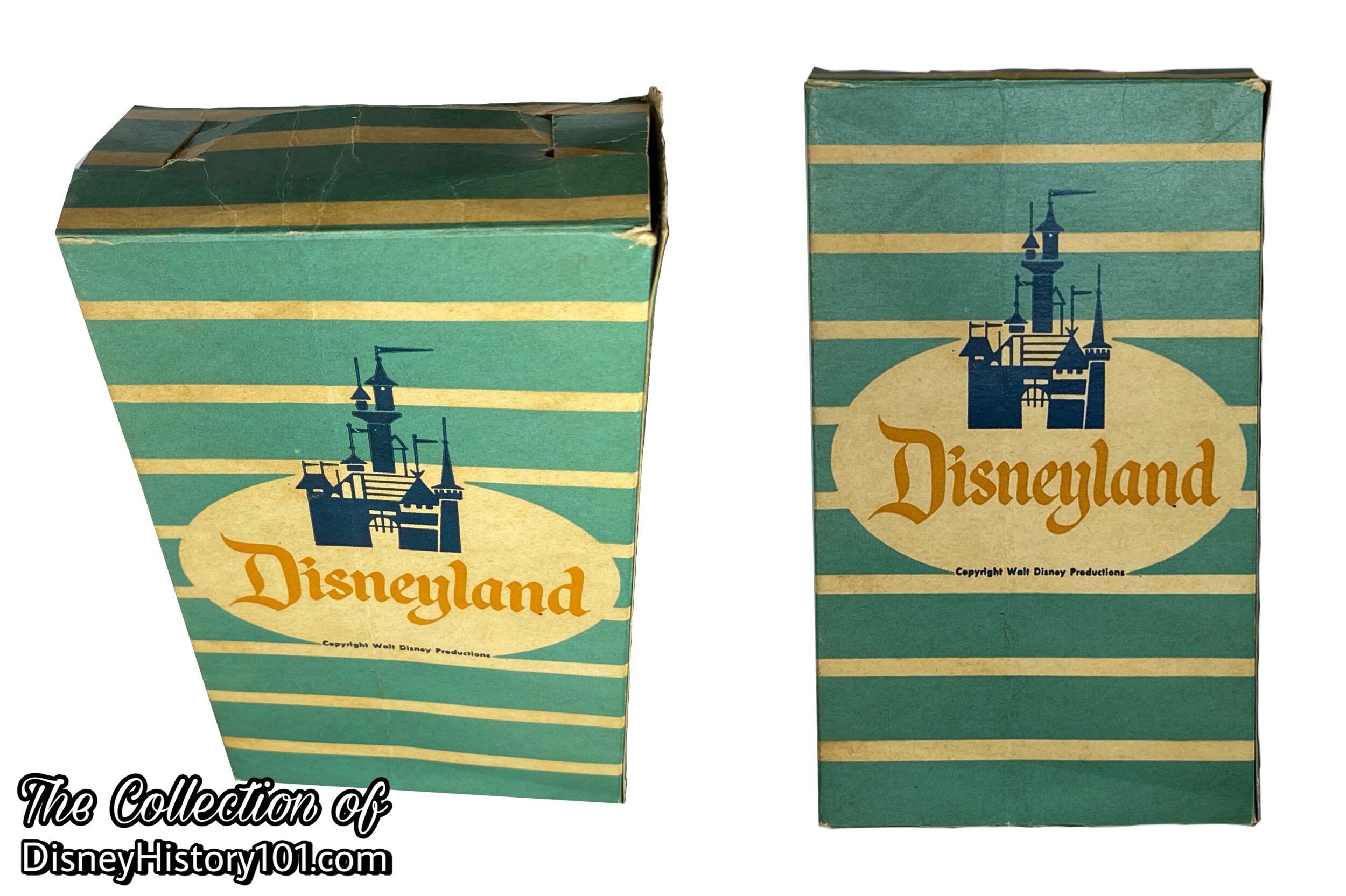
These boxes had the capability of being sealed (to take the extra popped and unpeopled kernels home). Still, these boxes were found small, and a newer design would soon allow guests to easily reach the popcorn at the bottom of the box.
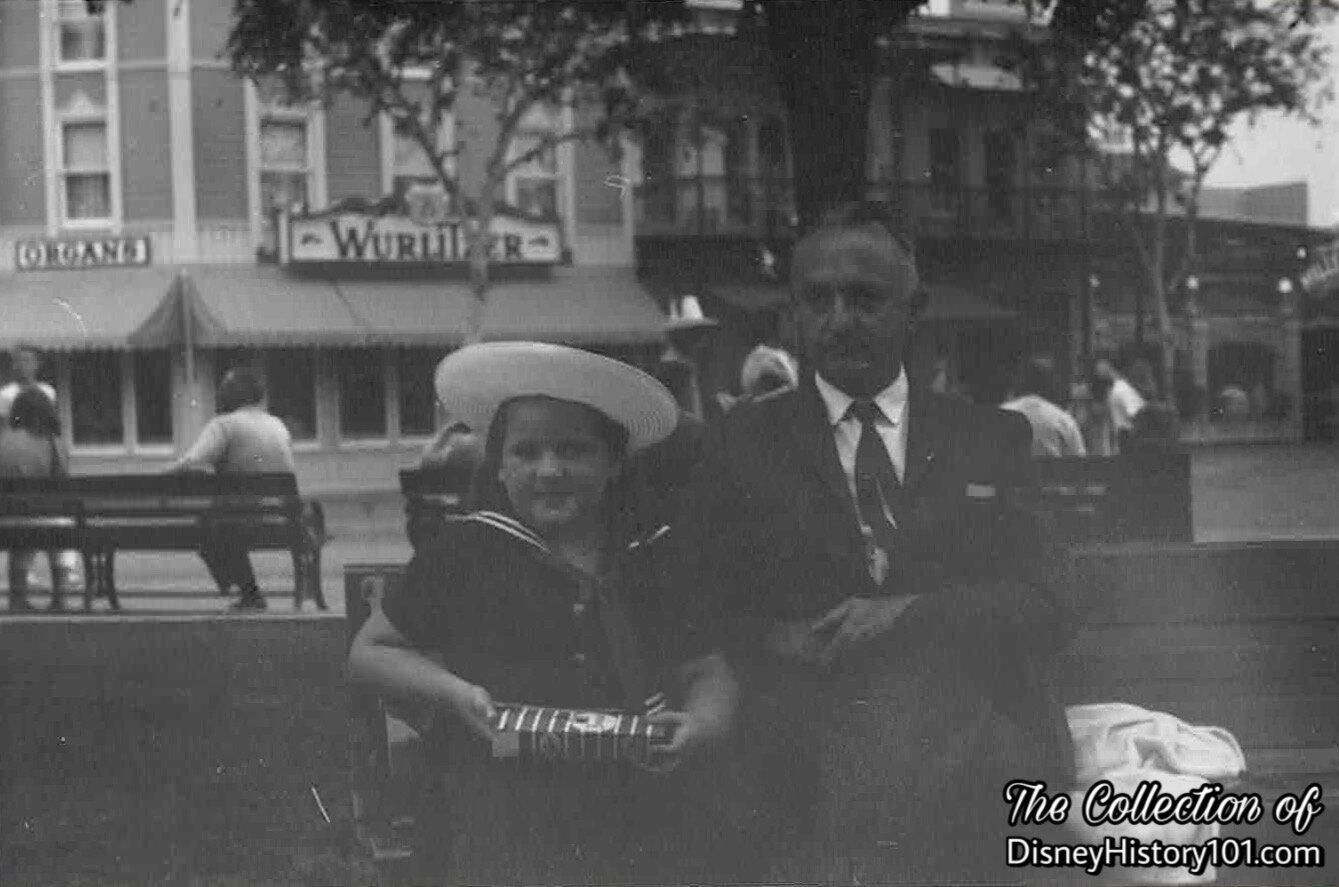
The first Disneyland Dictionary (printed in October of 1959) noted that the Popcorn Wagons
were operated by UPT Concessions served popcorn and peanuts, with two locations “in Town Square and on Center Street during peak seasons.”
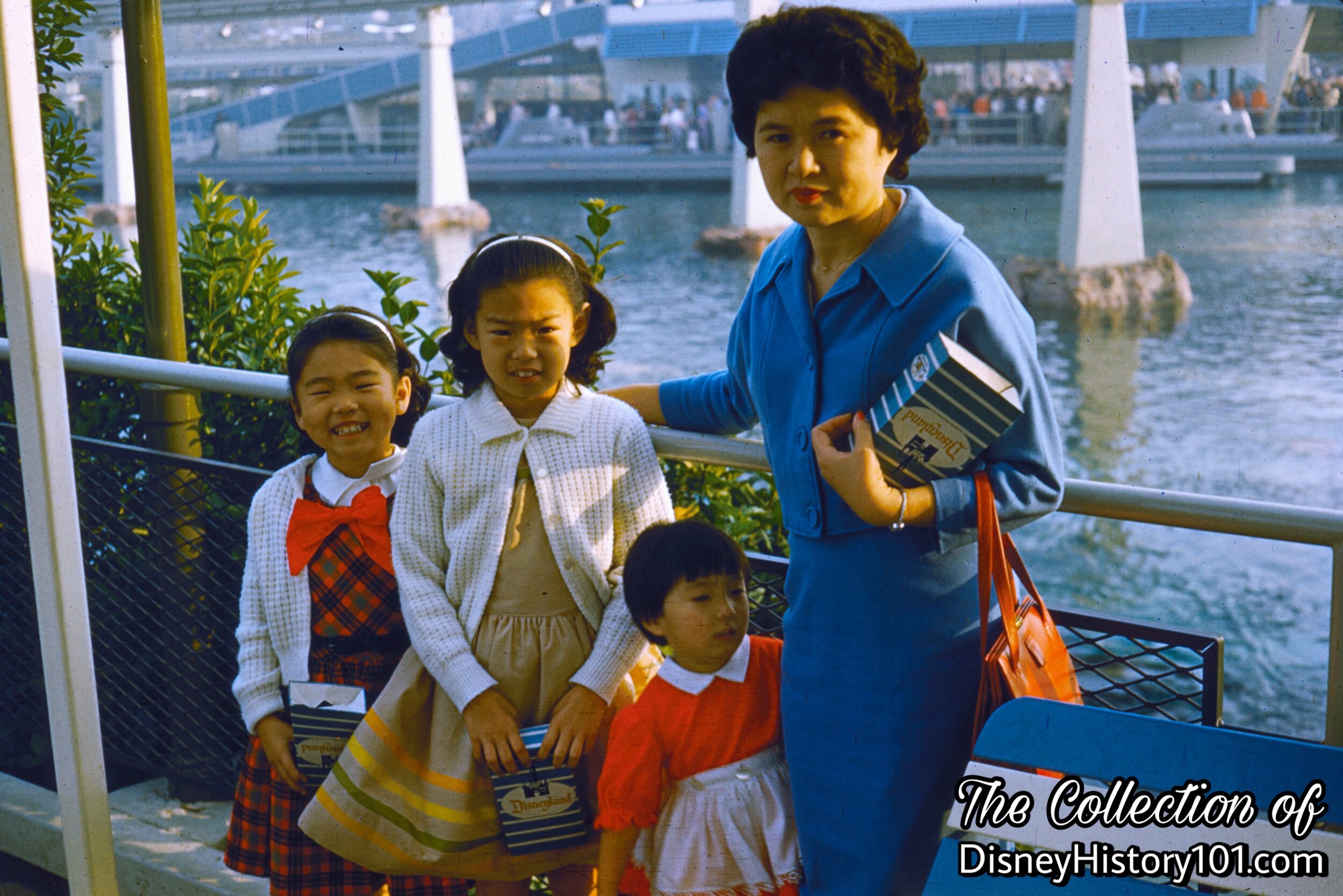
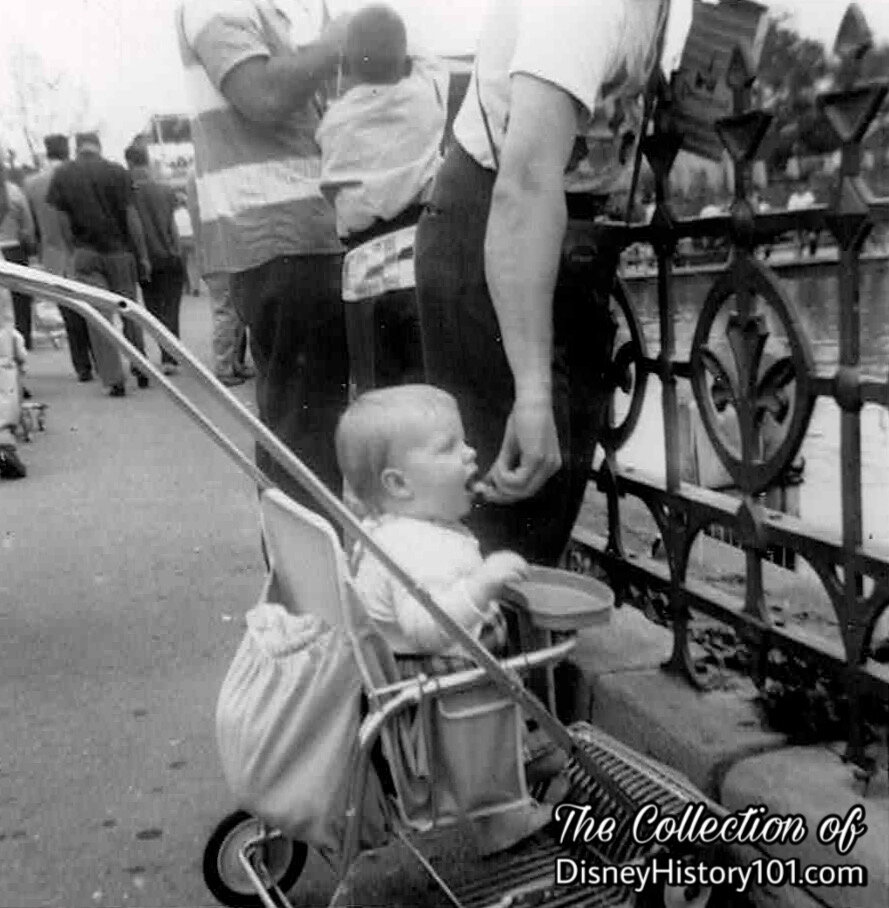
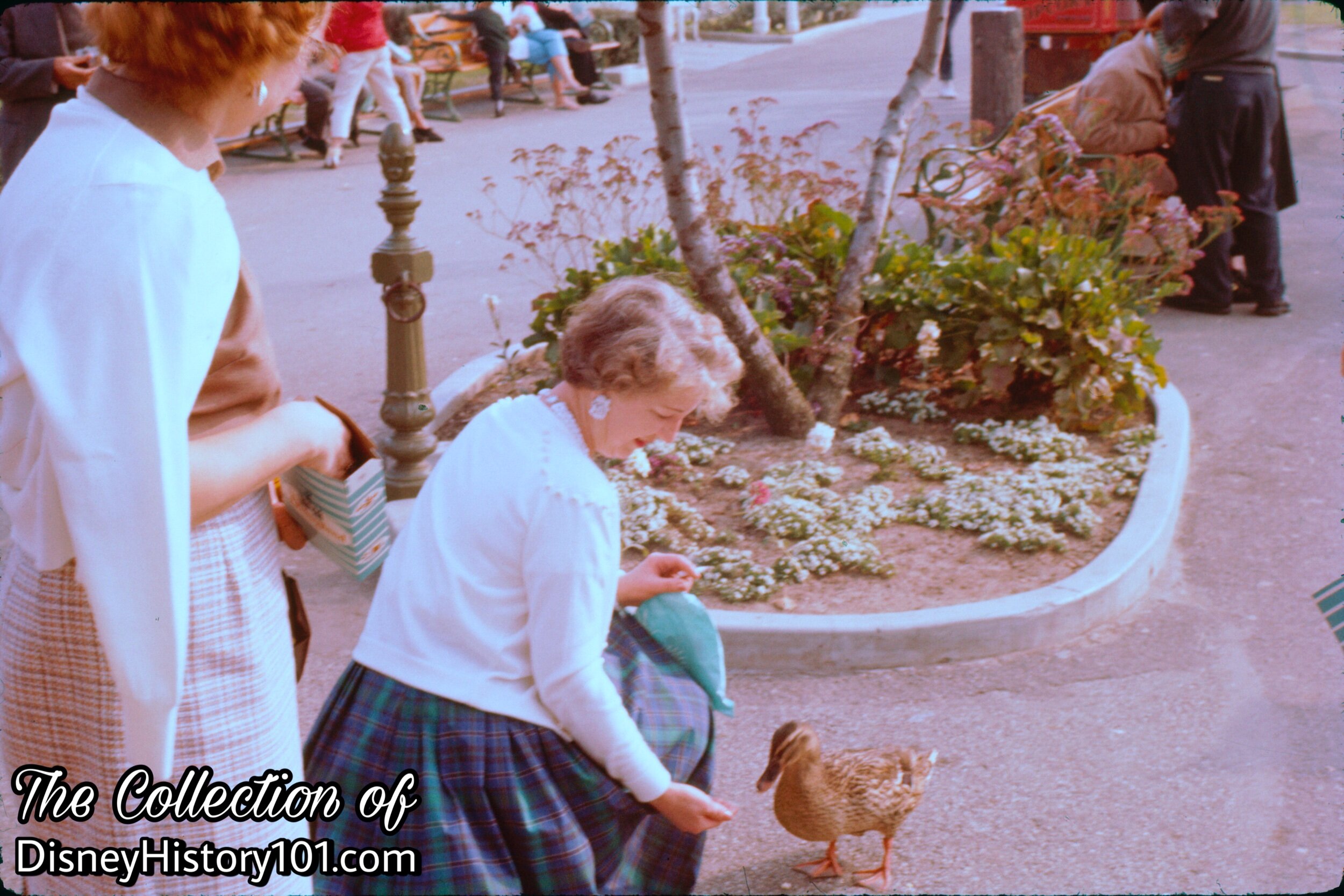
“A Brief Word About the Birds”
Human guests weren’t the only ones who found the “hot and fresh” popcorn served from Disneyland’s Cretors, irresistible! In the beginning, exotic wild geese, mallards, and other birds migrated to Disneyland. Others were either donated or purchased by Disneyland, Inc. something of an attraction in Disneyland. By 1959, the Rivers of America were teeming with white ducks whom were both raised and cared for by Disneyland, Inc. The Disneyland News (October 1956) once told the tale of Gertie the Duck who was “brought to Disneyland, and launched into the ‘Rivers of America’ from aboard the Mark Twain.”
Soon, other wild life of North America had “‘discovered’ Disneyland. Flocks of wild geese, mallards, and other birds have found Frontierland’s River a safe retreat in their pilgrimages south. The birds pause to rest here, and in some cases stay on for several months,” according to “A Complete Guide to Disneyland” (published 1956, 1957). The “Disneyland Dictionary” (published 1959) noted: “Wild geese, mallards, and other birds around the island and mainland in Frontierland migrated here, and the white ducks on the Rivers of America were raised by Disneyland.”
“55er” Mary Van Thyme recalled: “One time I was in my booth down on the raft dock and Milo Rainey and Bob Allen were on the dock. All of a sudden two ducks started fighting and biting each other's necks. So I called to Milo and Bob to put a stop to it. Milo strolled over, and with a big grin, said, ‘Don't be silly, dearie, haven't you heard about the BIRDS AND THE BEES?!’”
These feathered guests also took the opportunity to do more than rest - they dined! As you can see in the picture (above), some guests couldn’t help treating their feathered fellow guests to morsels of popcorn. The Wonderful World of Disney episode “Holiday Time at Disneyland” (1962) displayed images of a young guest tossing popcorn to feathered guests in the water, while the narrator joked, “Its no wonder when ducks fly into Disneyland, they make it their permanent home!” But therein was highlighted a problem - once the birds learn where to find “hand-outs,” they would never leave the Park. Even more, according to Backstage Disneyland magazine (Vol.1, No. 2, December, 1962), there persisted a “problem of ducks sleeping on our many ferocious wild animals throughout our park.”
These charming “Disney ducks” have continued to captivate guests, proving it isn’t so “tough to be a bird” as they manage to discover occasional "handouts” near concessions. While at Disneyland, never mind what the “little old bird woman” says, because Guests are presently discouraged from feeding the birds! Ducks they do not require them, as they cleanup show contradictions like fallen popcorn that have a huge impact on the guest experience.
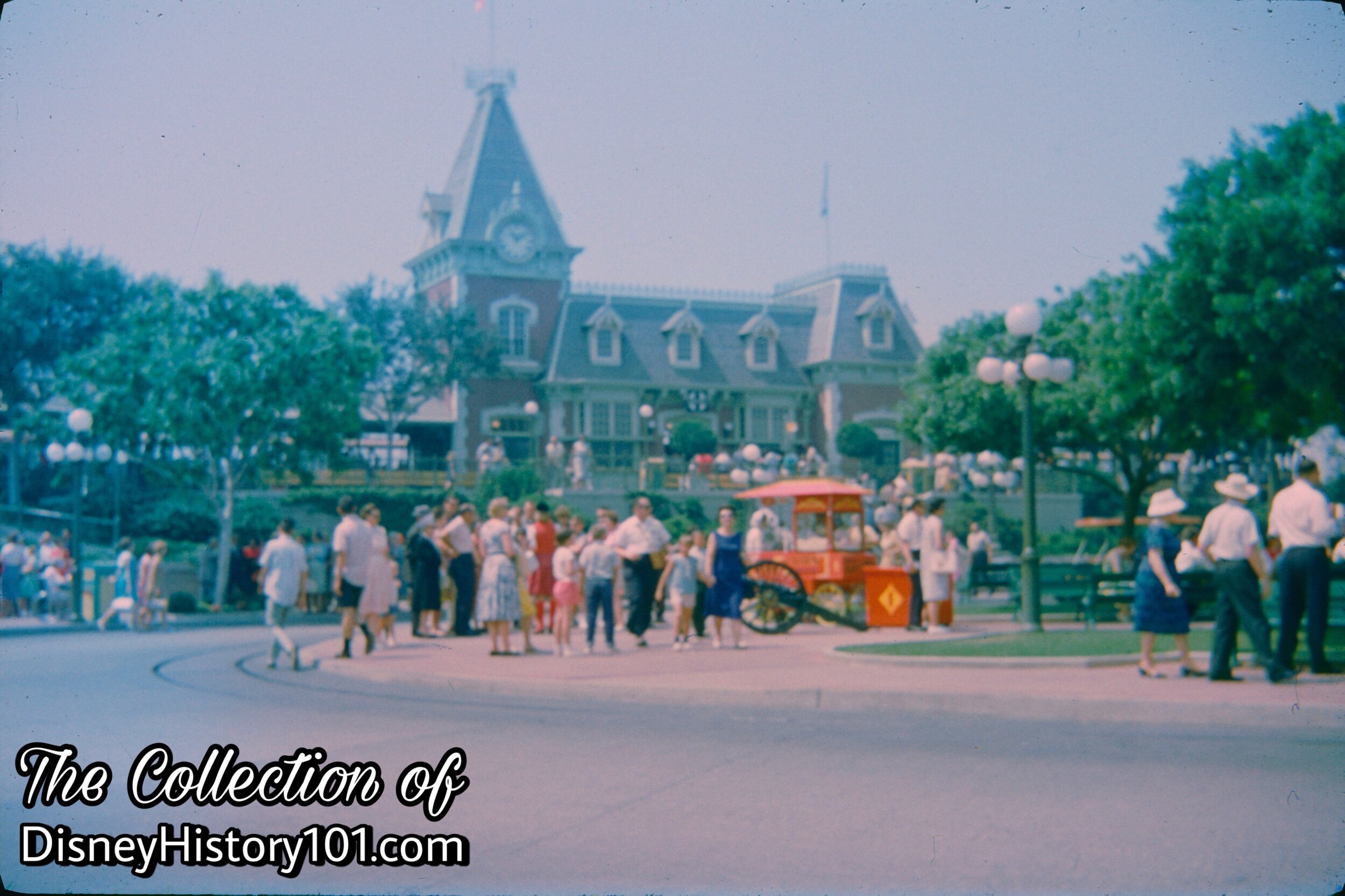
A Cretor services the Main Street USA crowd!
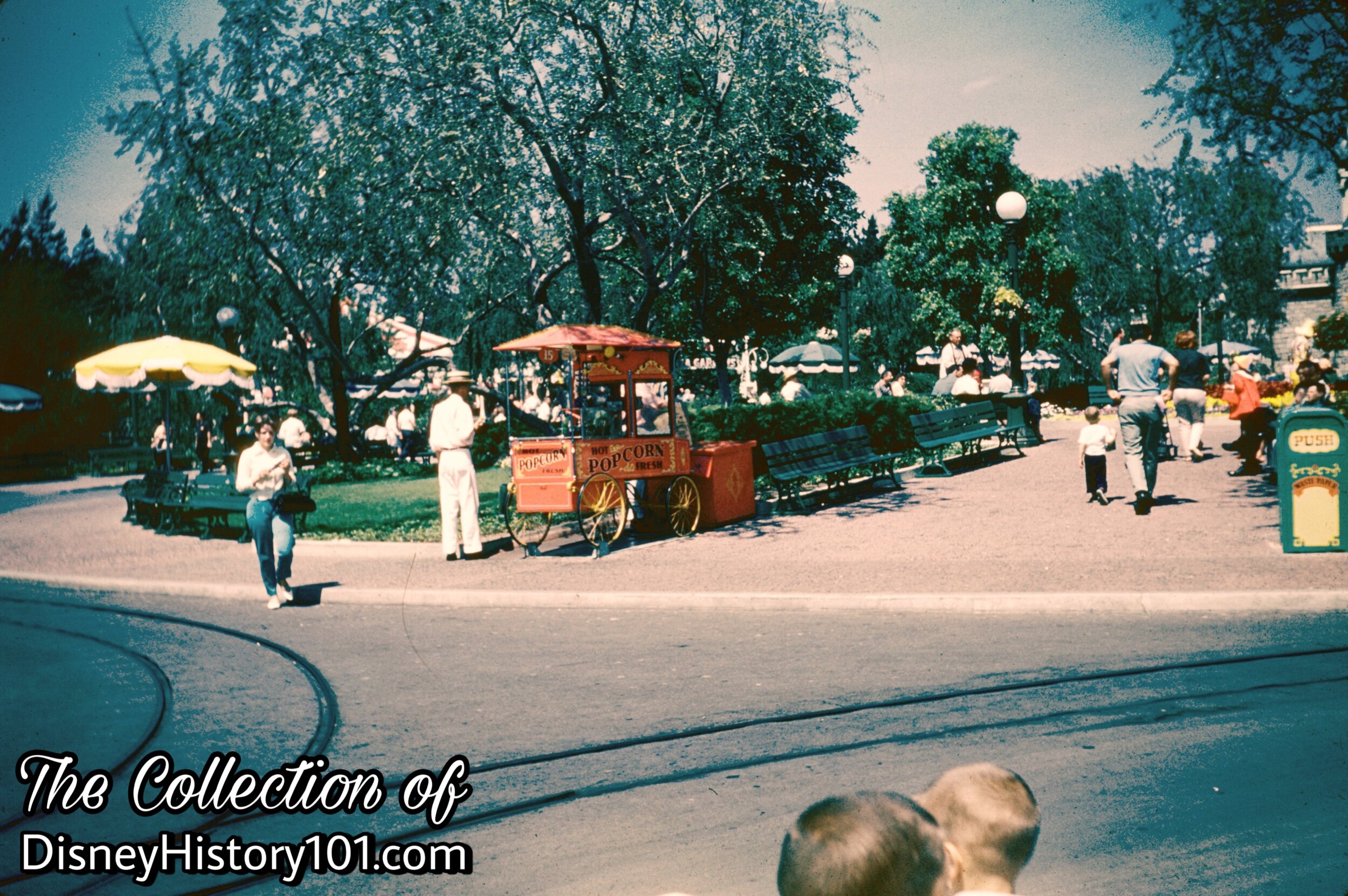
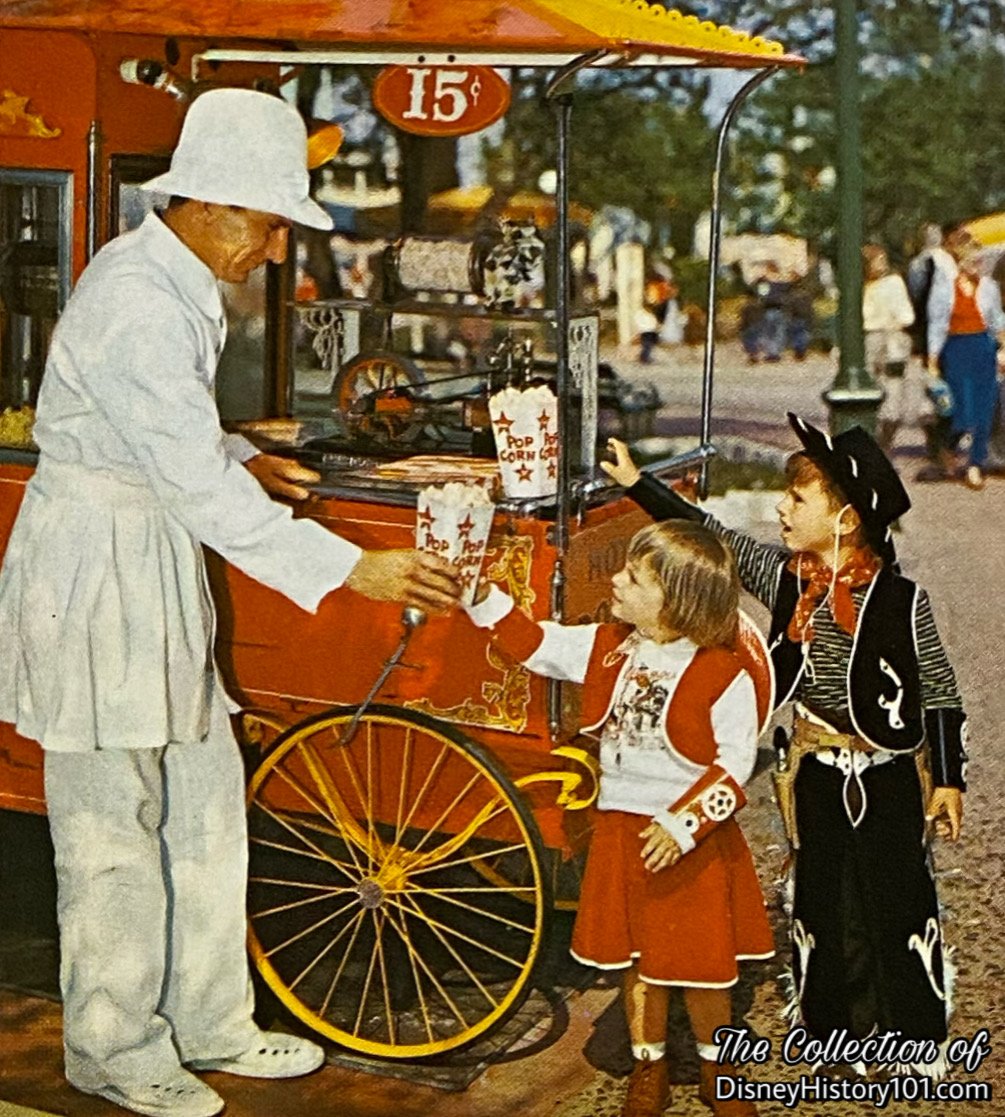
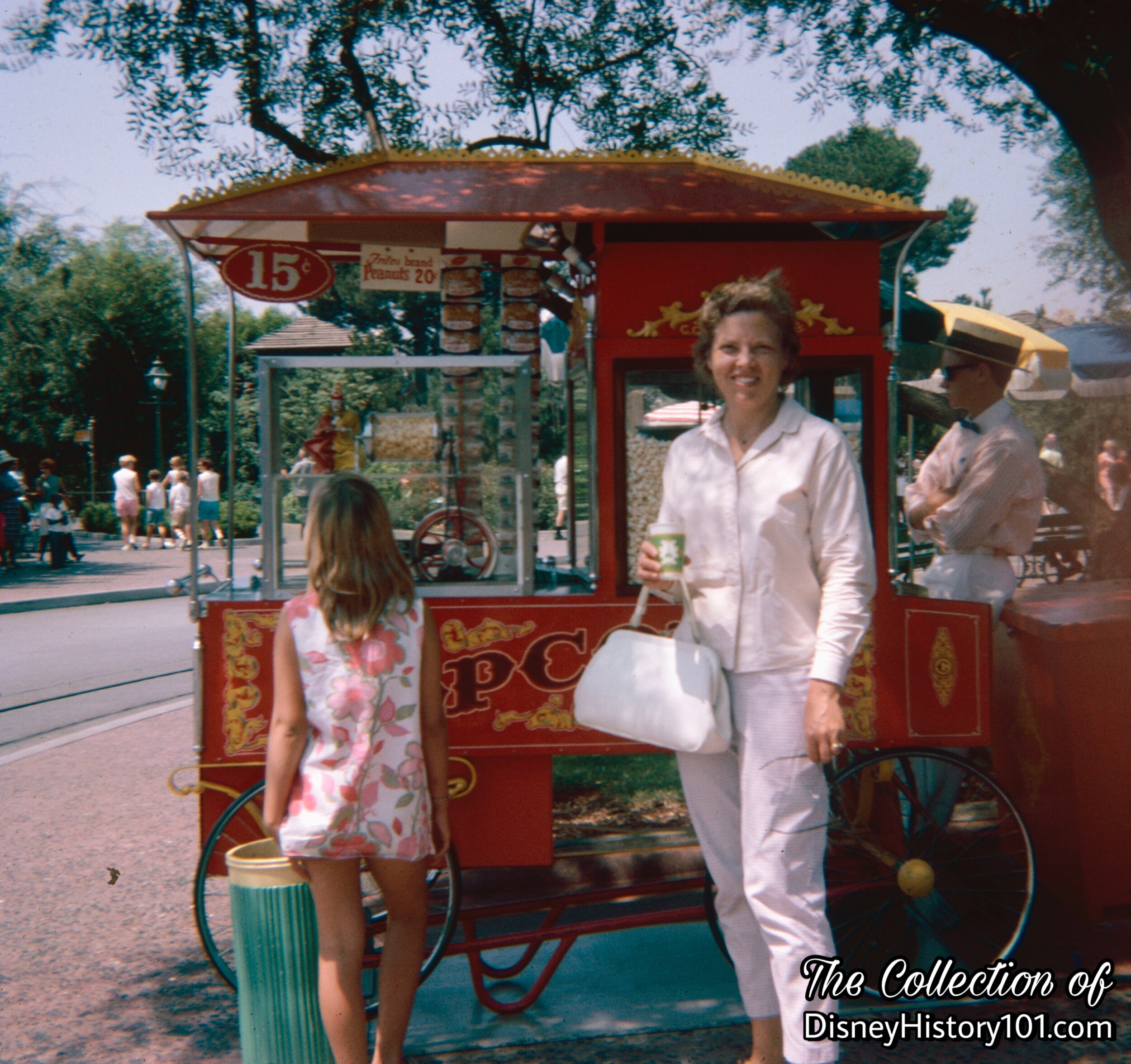
During the 1960s, Disneyland Concessions (like Fantasy 1 & Fantasy 2), the Ice Cream carts, and the Popcorn Cretors were run by United Paramount Theaters. During this same era (c. 1966), Disneyland Popcorn Cretors offered more than hot fresh popcorn. Hot and fresh Fritos Brand Peanuts were also offered, as an alternative light snack, at 20 cents a box!
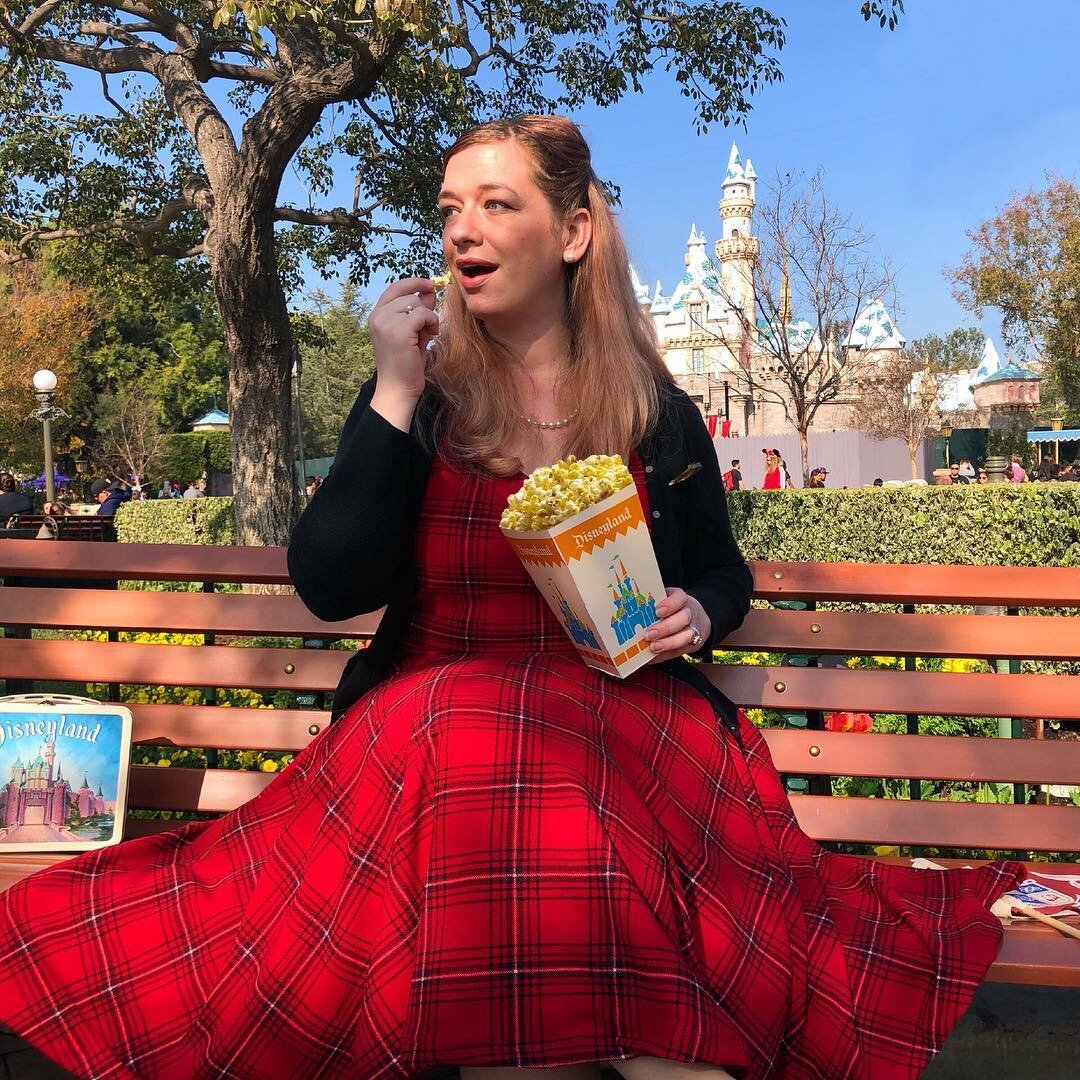
Still, long before the novelty popcorn buckets, the main attractions at the Cretor carts were (and continue to be) each and every one of their hot and freshly-popped buttery kernels! Now, packaging is essential to catching the attention of guests. As Disneyland would enter the 1960s, Disneyland popcorn boxes would feature new designs and eye-popping design graphics (similar to the one pictured above)! These were used until 1967.
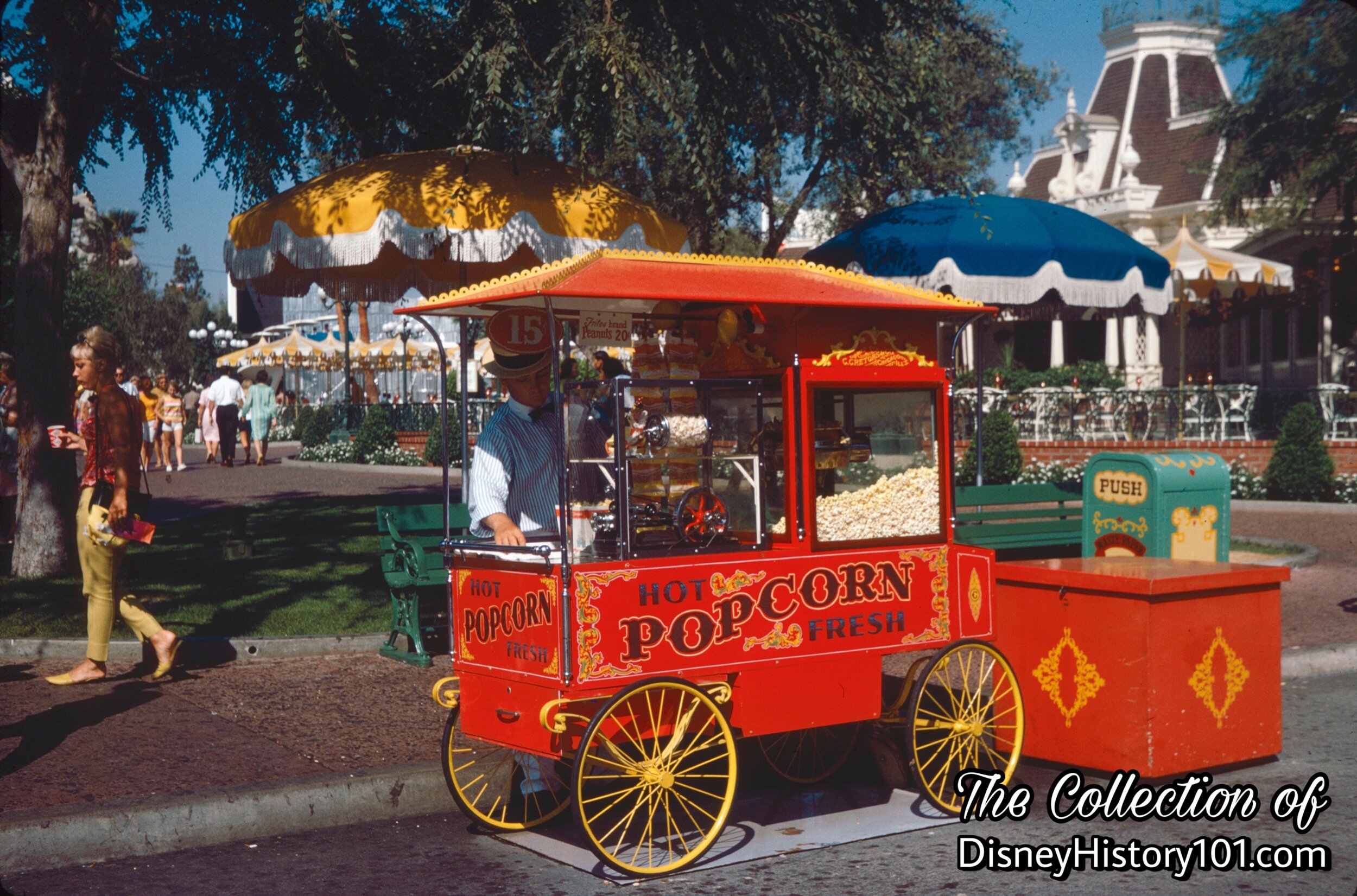
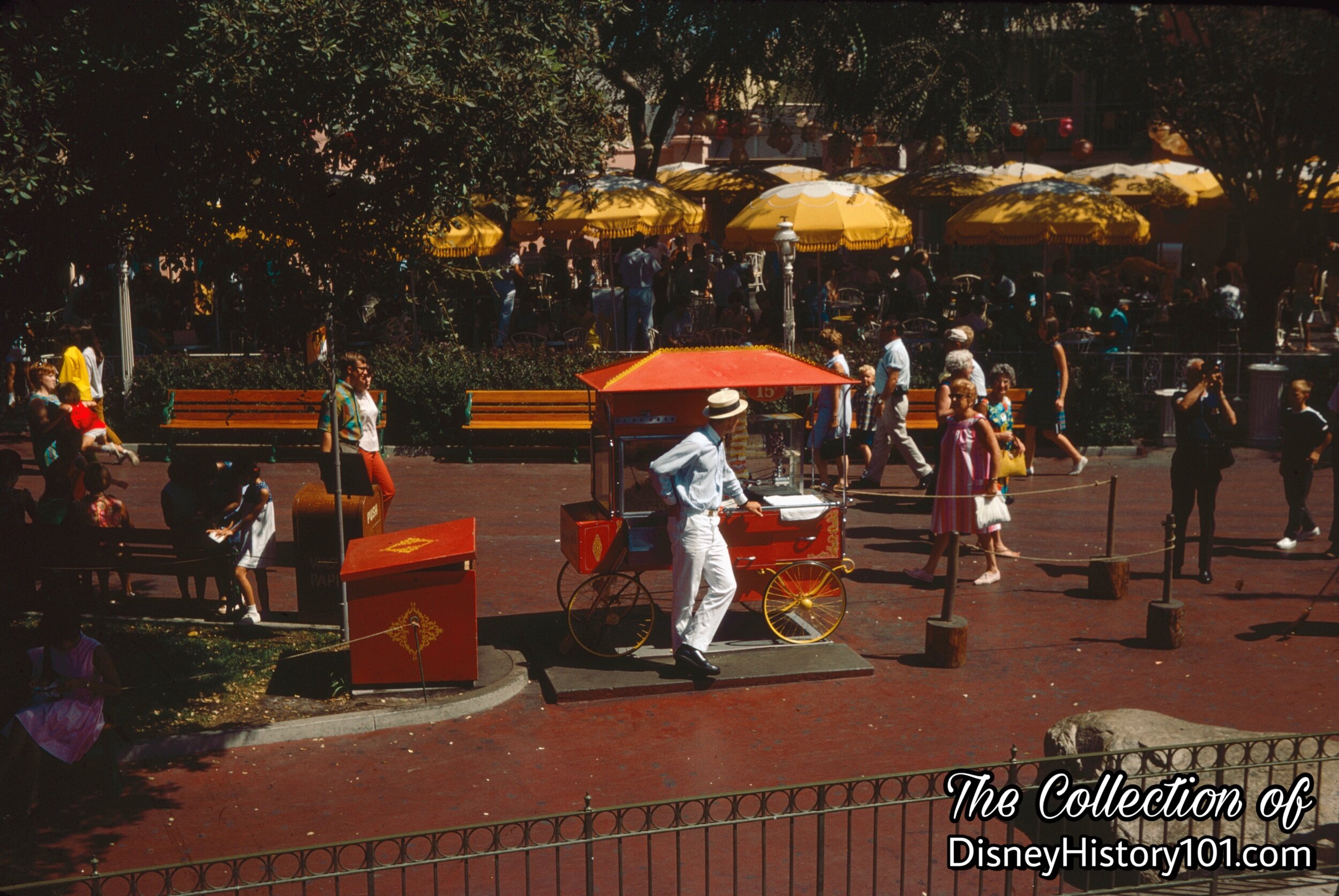
A Cretor sits in the main thoroughfare of Frontierland, along the Rivers of America, c. 1967.
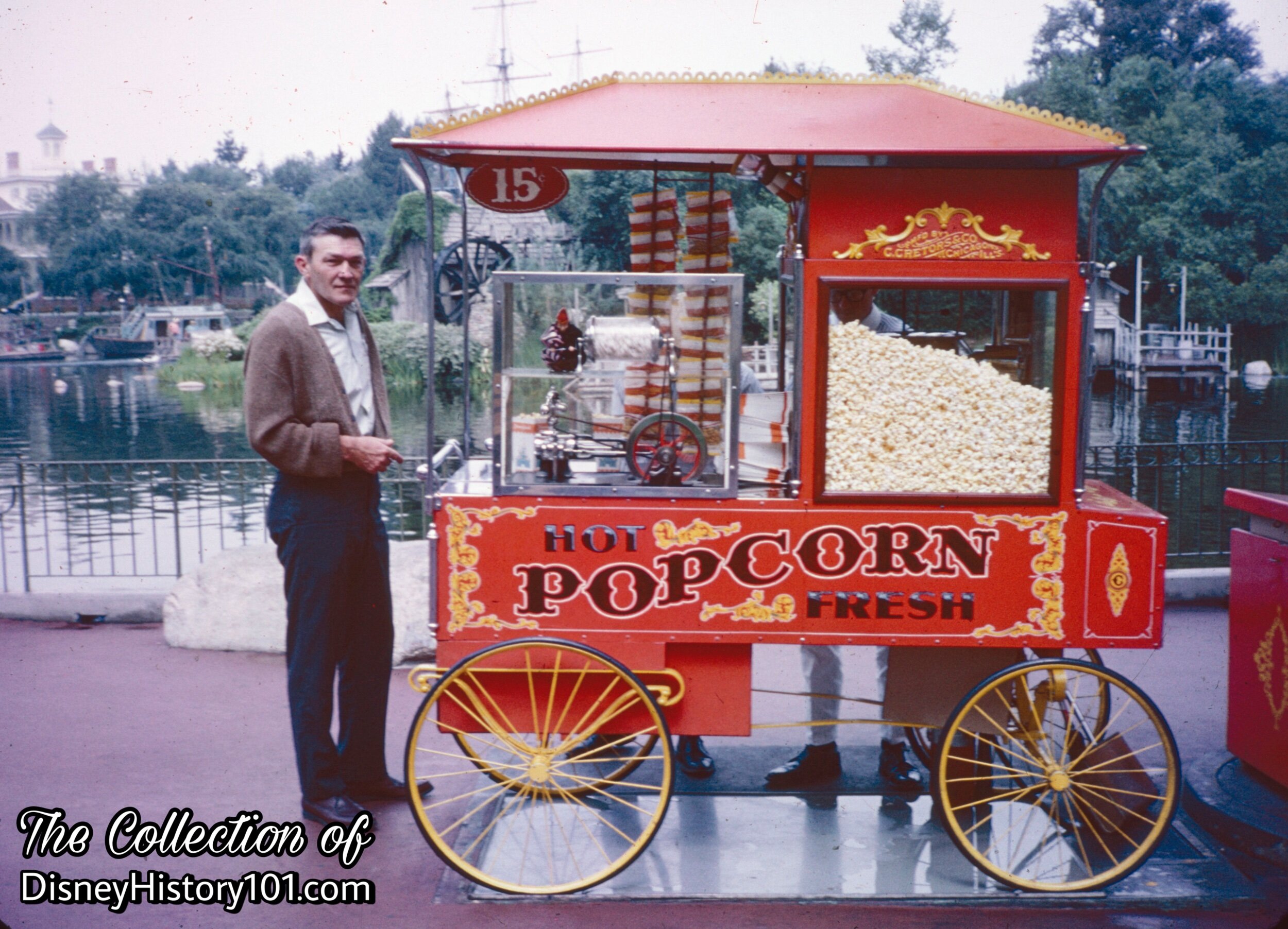
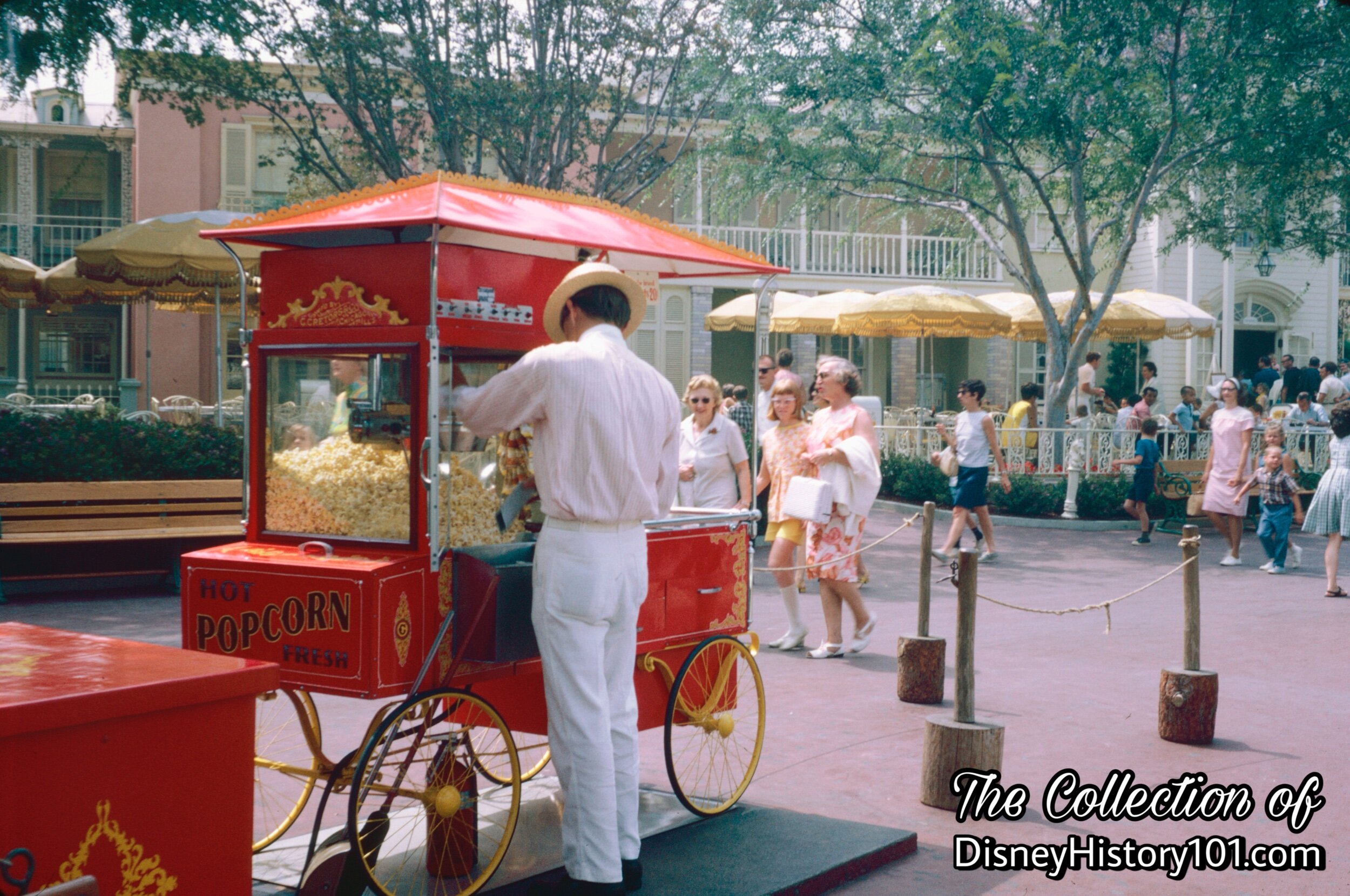
Popcorn prices would increase slightly (by five cents) in 1968.
By 1969 it was figured: “Our popcorn supplier figures it out. We sell enough popcorn every year to cover an area of 30 acres with a layer of popcorn three inches thick, and our guess is that about five acres of that is spilled at one time or another.“ [“THE MAINTENANCE OF MAGIC IN THE ‘MAGIC KINGDOM’”]
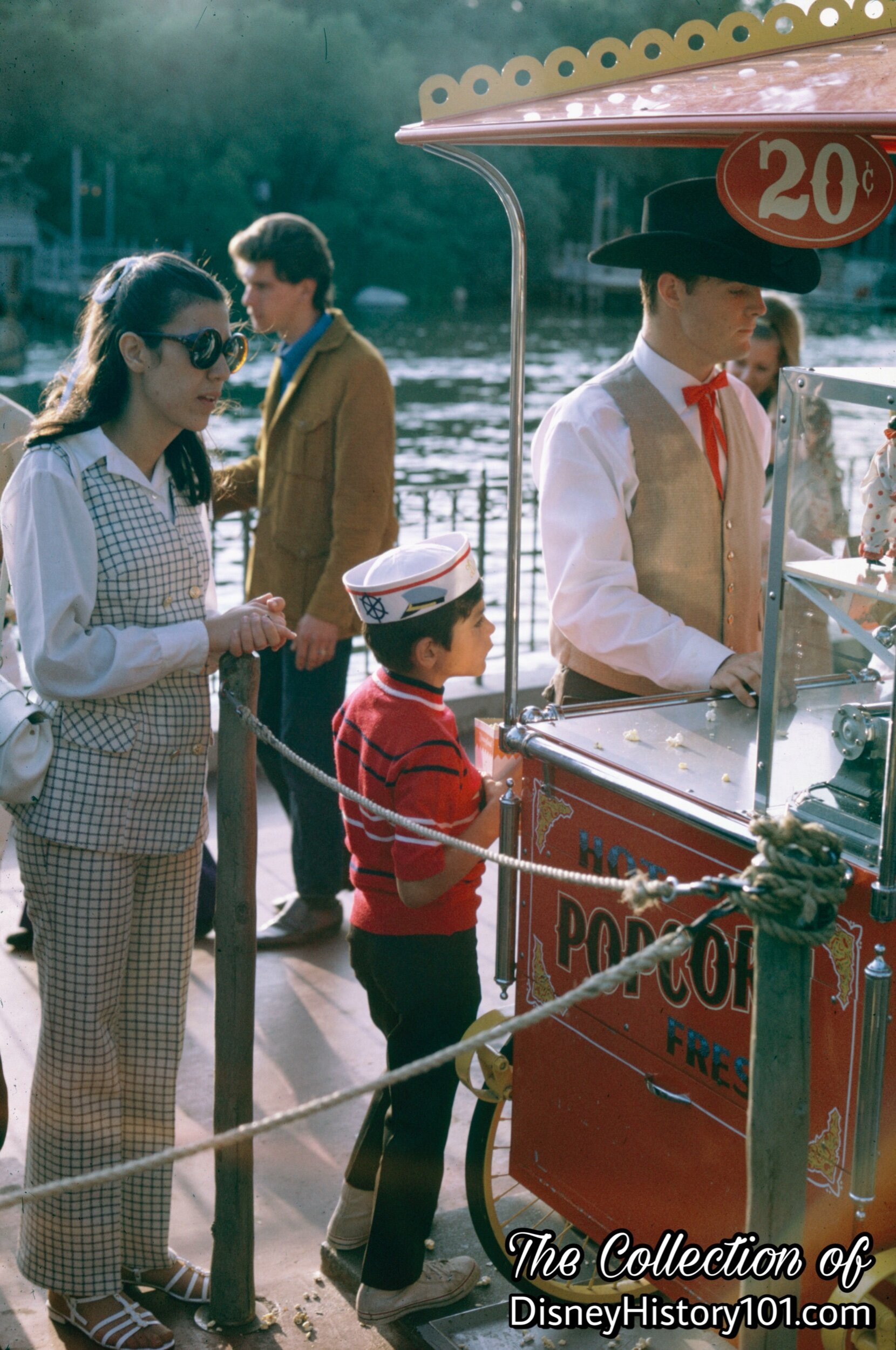
By the 1970s, Disneyland’s Popcorn Cretor pots were changed from Cretor brand to Manley brand. Also, by about 1971, McGlashan Enterprises a division of Buena Vista Distribution Co., Inc. (the same company that manufactured and designed air cannons, lead shot, and plastic ammunition in addition to shooting galleries and air rifles for Disneyland) had designed and was manufacturing a line of custom-crafted popcorn wagons for Disneyland, Walt Disney World and other amusement facilities in the U.S., Canada, and Belgium.
The price point for one serving of Disneyland Popcorn - 20¢. Still, during peak periods of operation (c. 1973), “as many as 1,000 people” bought “a box of popcorn from one wagon in just one hour,” according to “Food Showmanship Disney Style”, published 1973. According to the same publication, “On a busy day the outdoor food hosts, working from seven wagons located throughout the Park, will sell as many as 33,000 boxes of popcorn.”
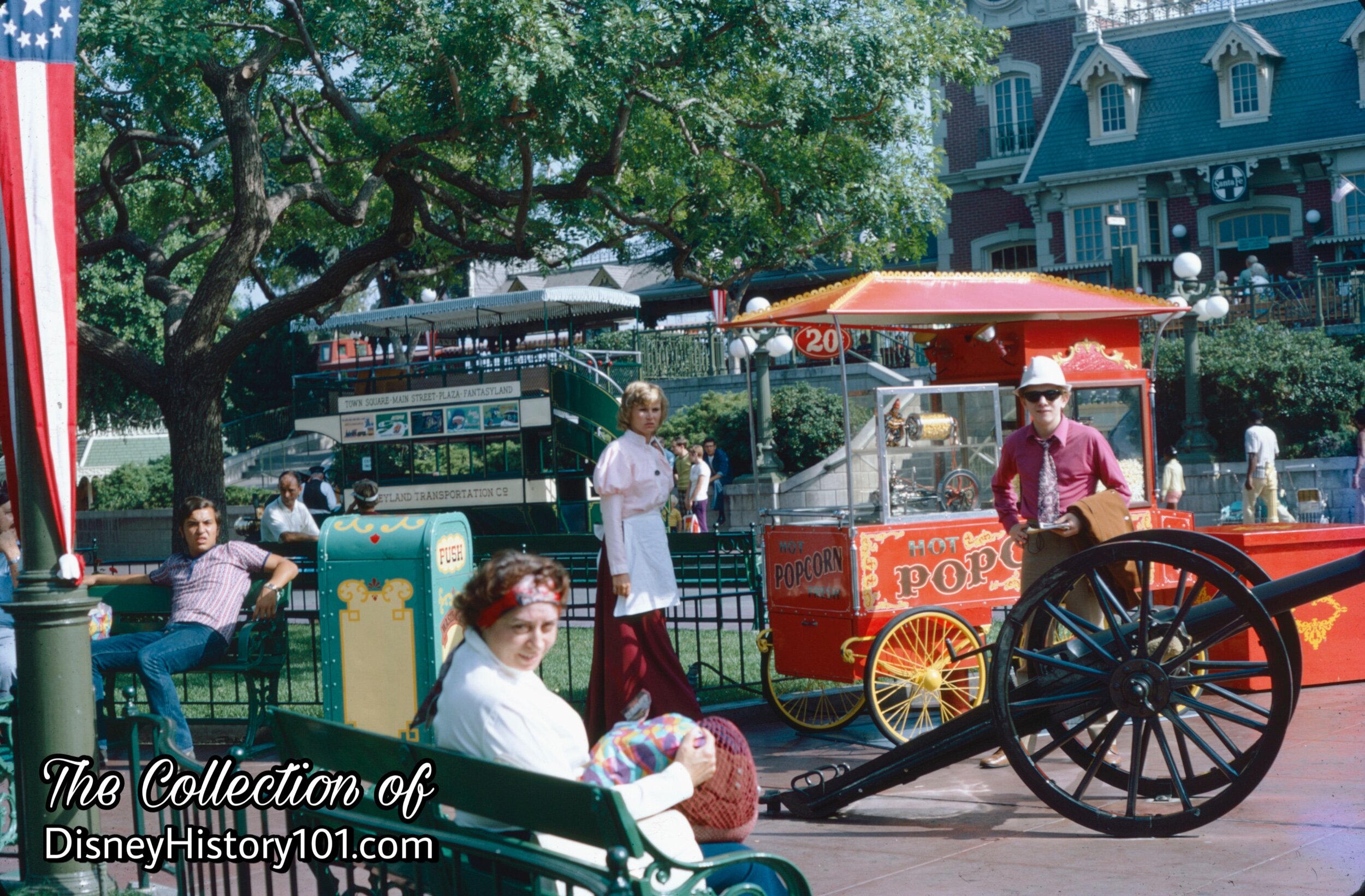
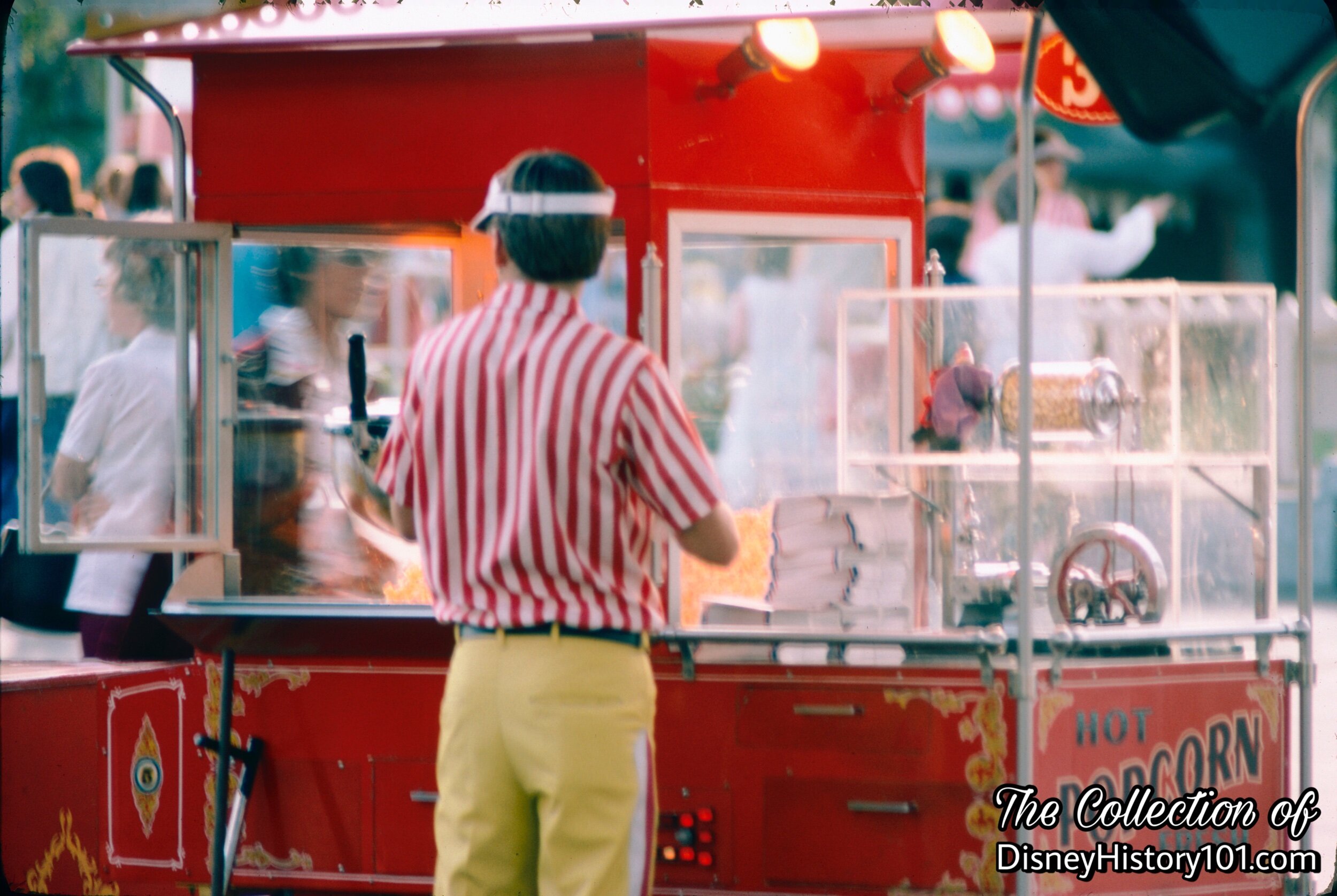
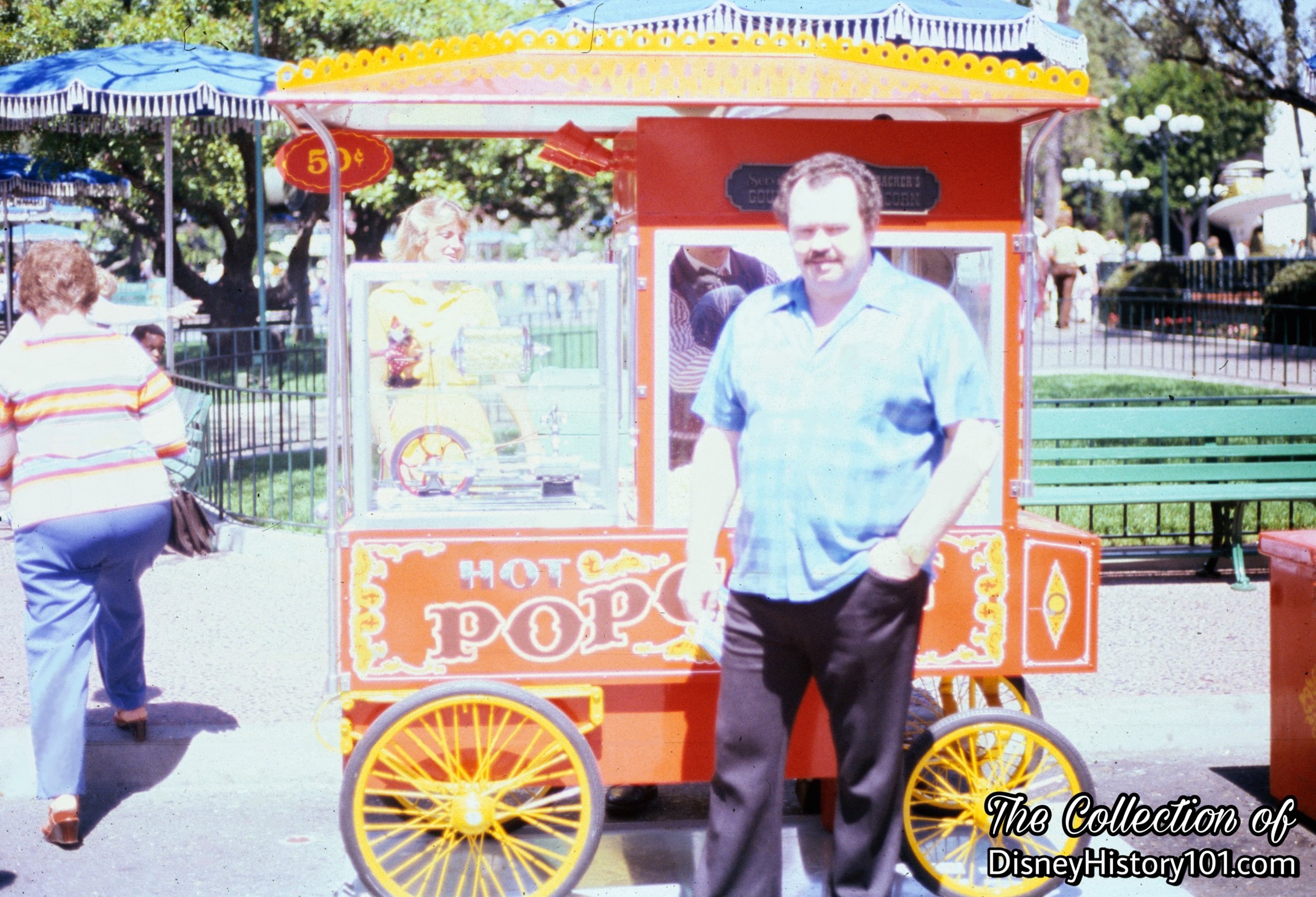
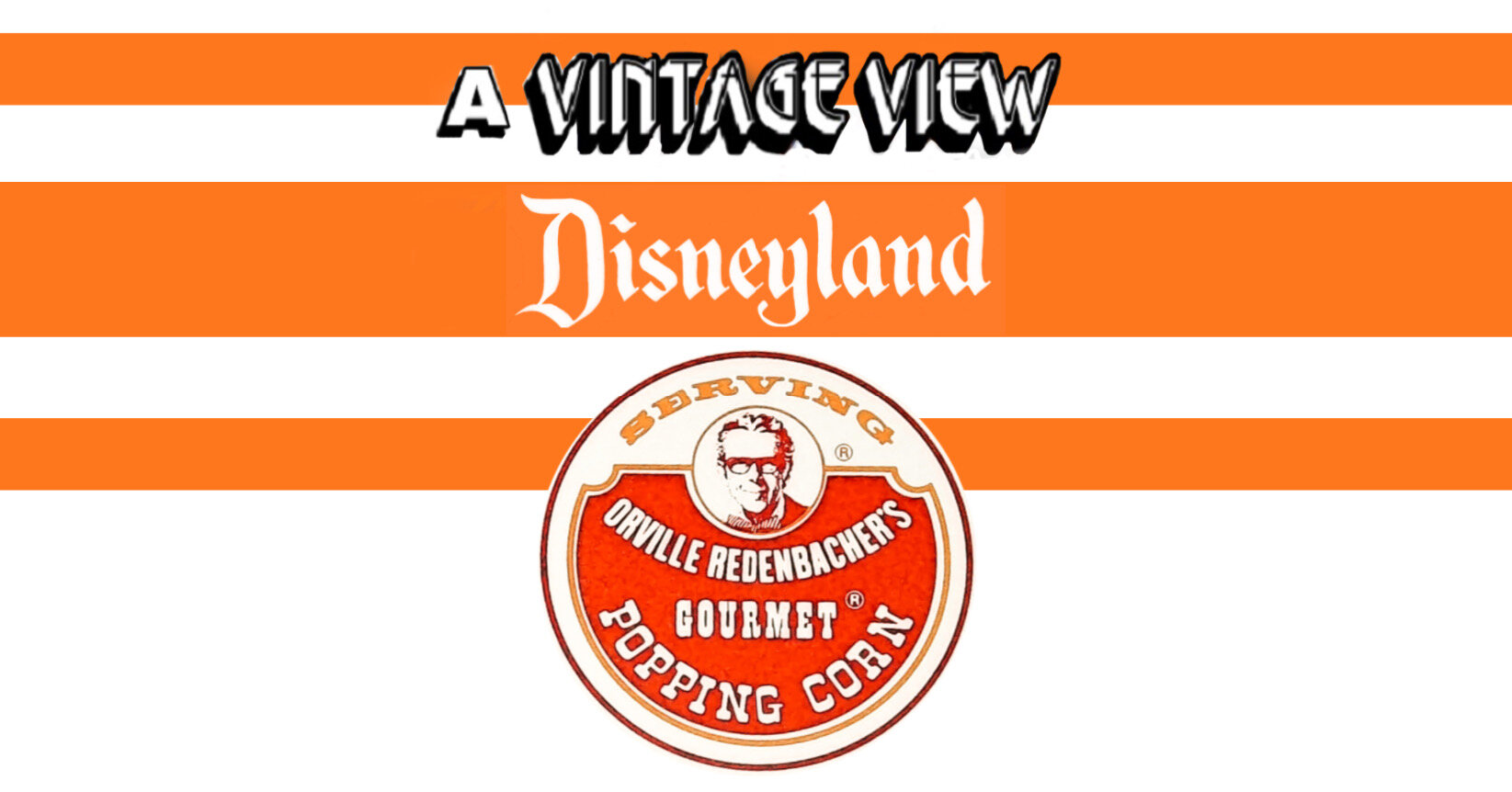
In the early days of Disneyland corn was purchased from farms. Cal McMurtrey recalled: “We got a farm near Pismo Beach and we raised hybrid corn for poppin...it had small kernels. We had 500 acres and I remember one time I had gotton the whole crop sold to Disneyland. It was in 600 sacks and each sack was a hundred pounds. But by the time I got back to tell Dad, he'd had it all ground up into chicken feed!”
Decades later, Orville Redenbacher became the official popcorn of Disneyland during a special daytime ceremony on February 24th, 1977! After this momentous occasion, “hot, buttery and finger licking good” Orville Redenbacher Gourmet Popping Corn continued to be offered at various Popcorn Wagon locations throughout the Park. Over in Walt Disney World, an average of 90 tons of popcorn was sold to guests annually. Soon, Cast Members were invited to attend festivities and meet Orville Redenbacher in person at the Village.
After Orville Redenbacher became the official popcorn of Disneyland, Disneyland LINE magazine (published for Cast Members) ran the following story.
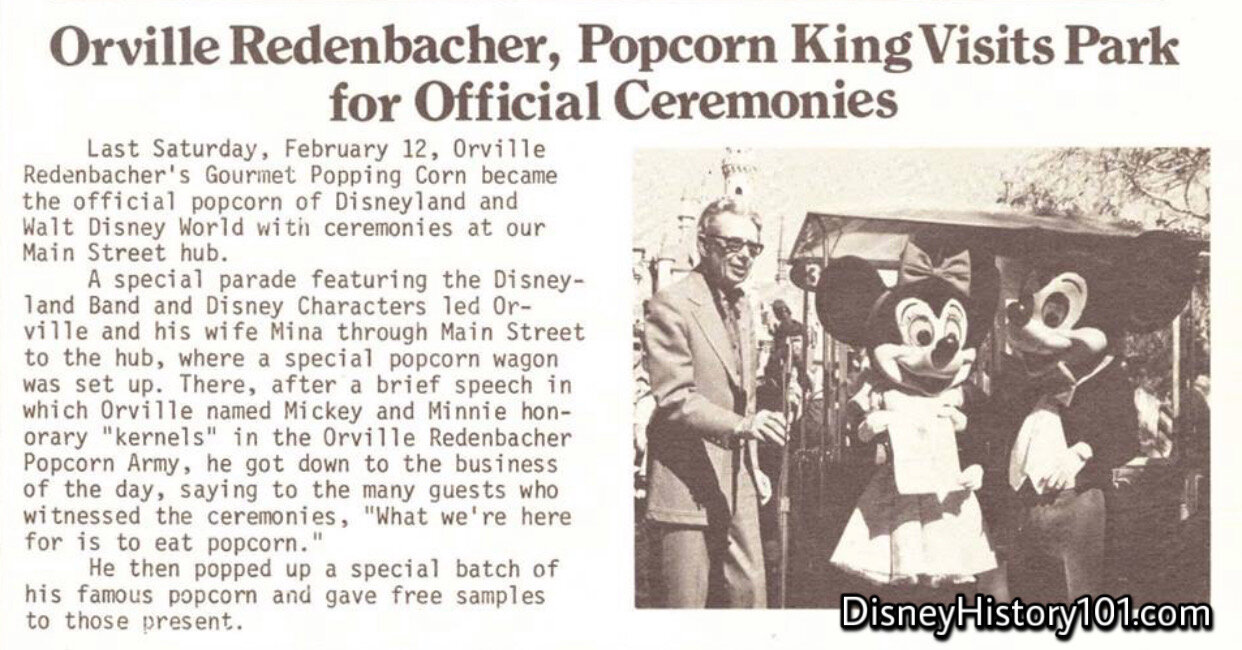
By 1990, Disneyland audiences were purchasing 3.2 boxes of popcorn annually from various locations around the Park.
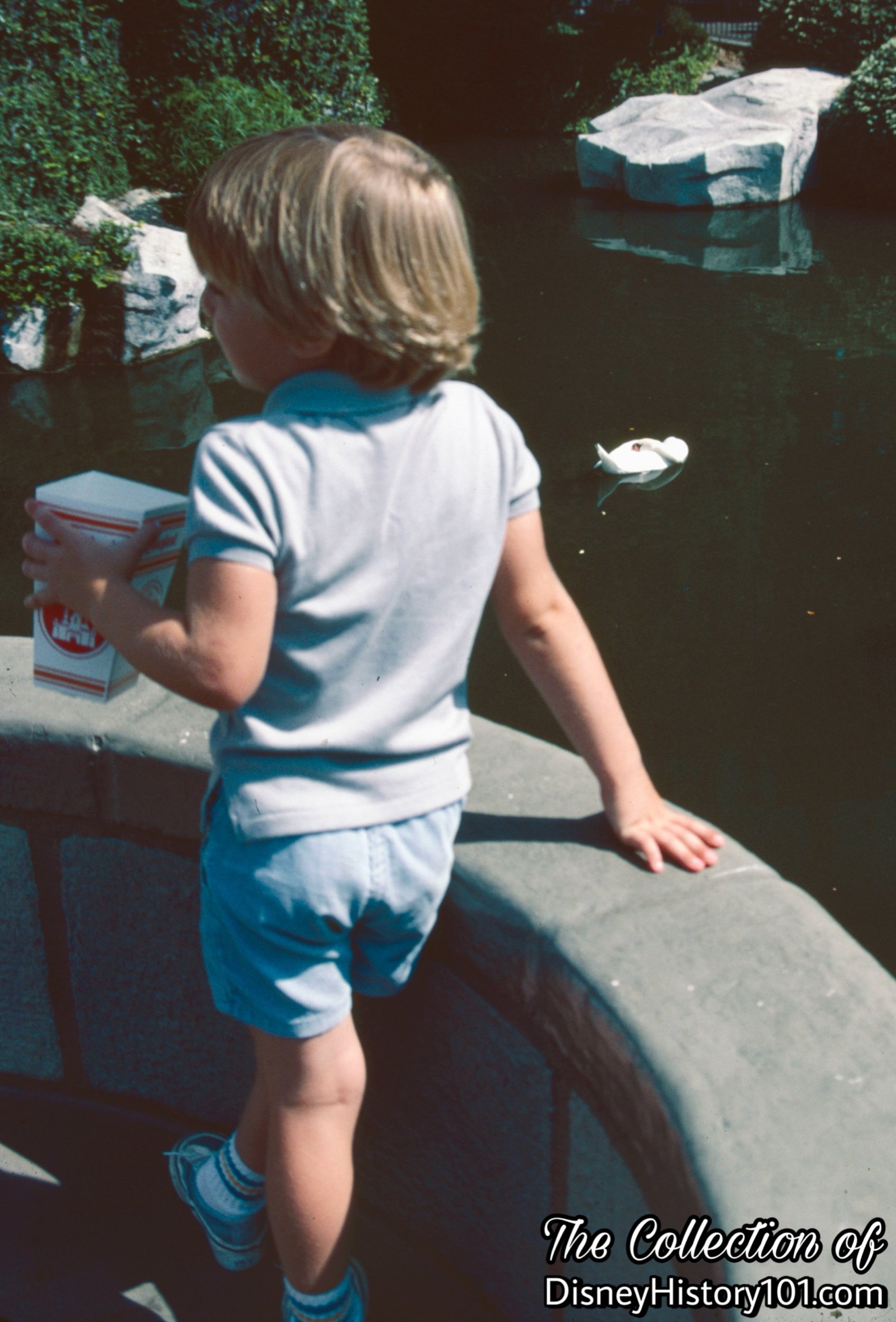
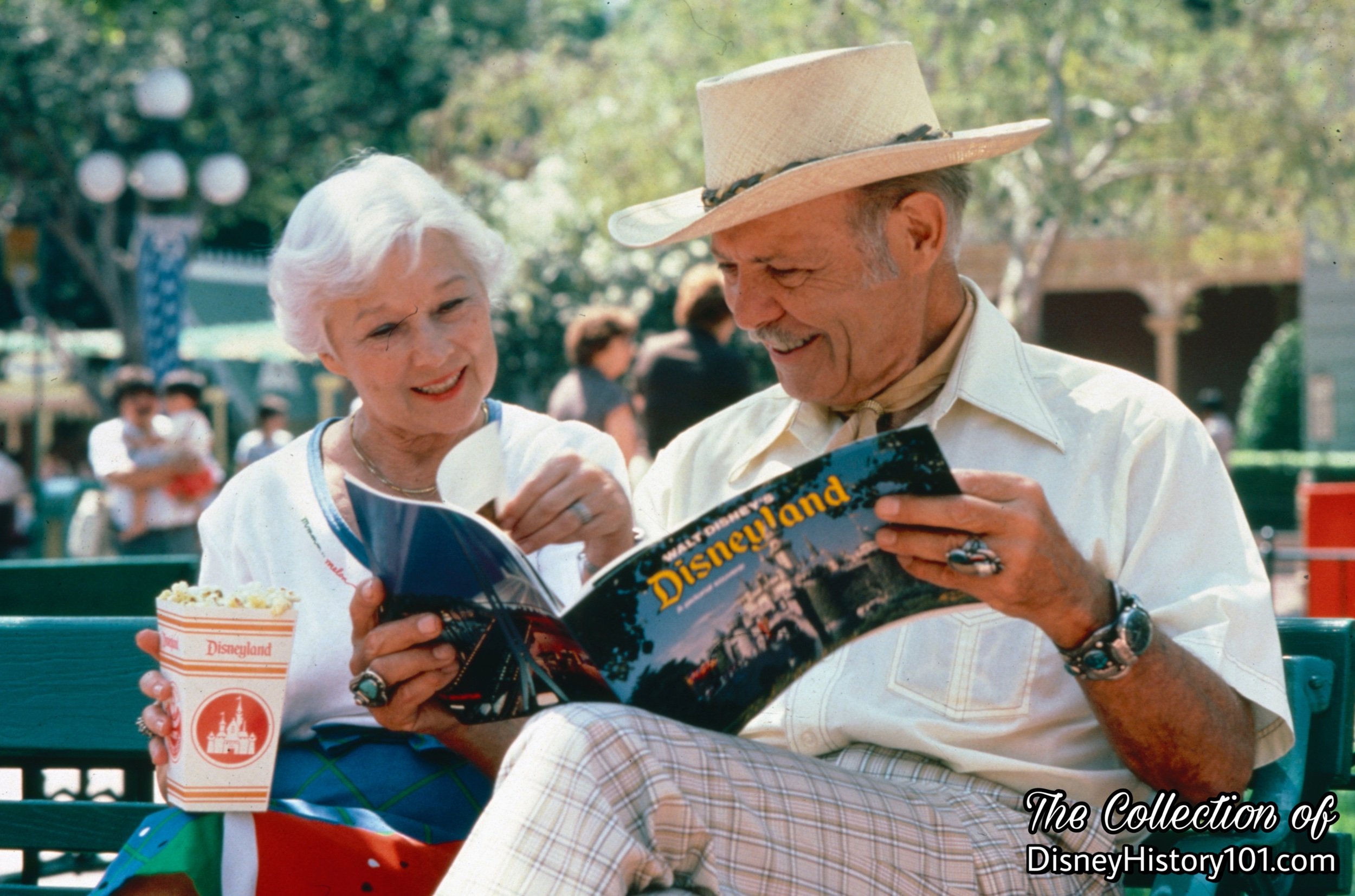
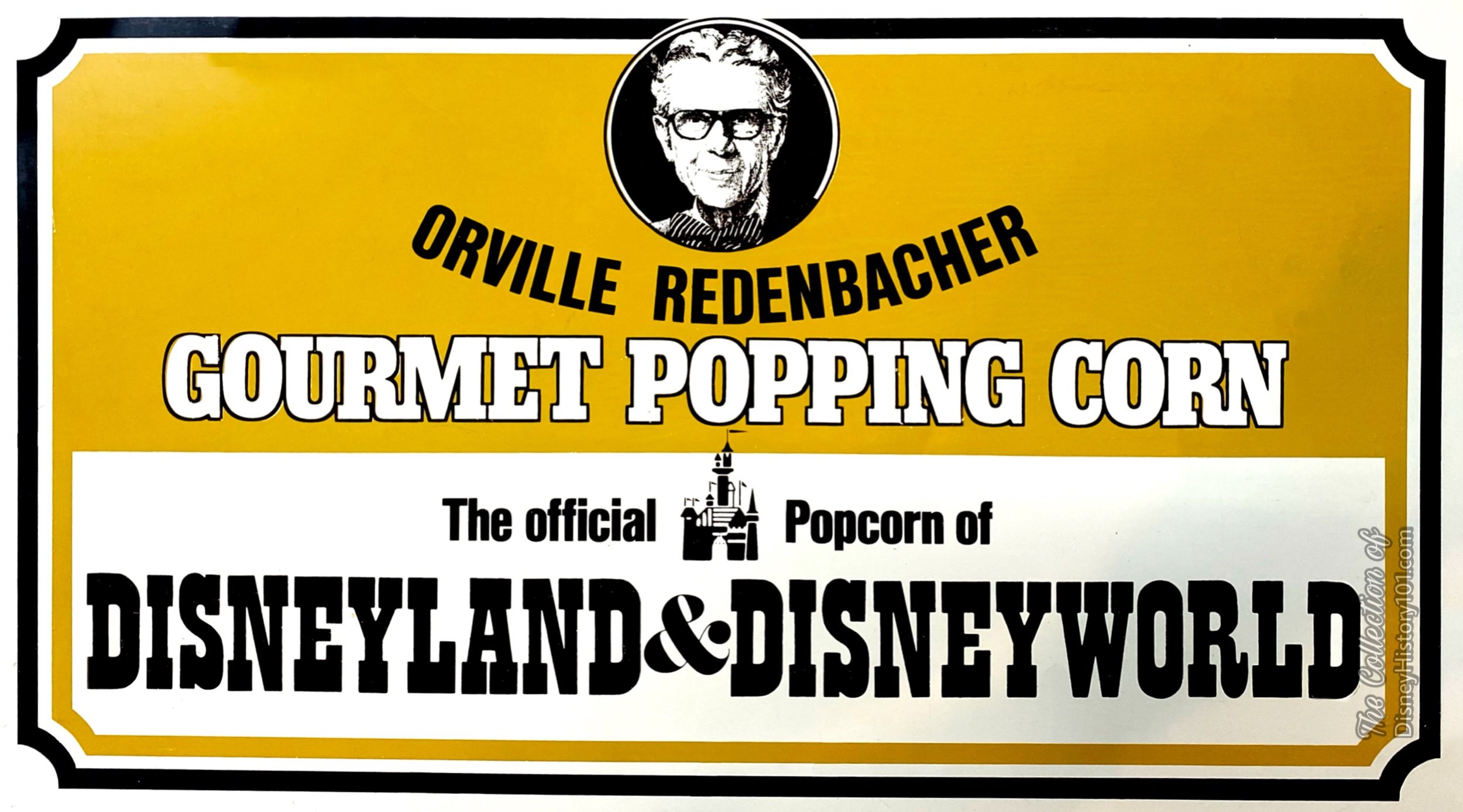
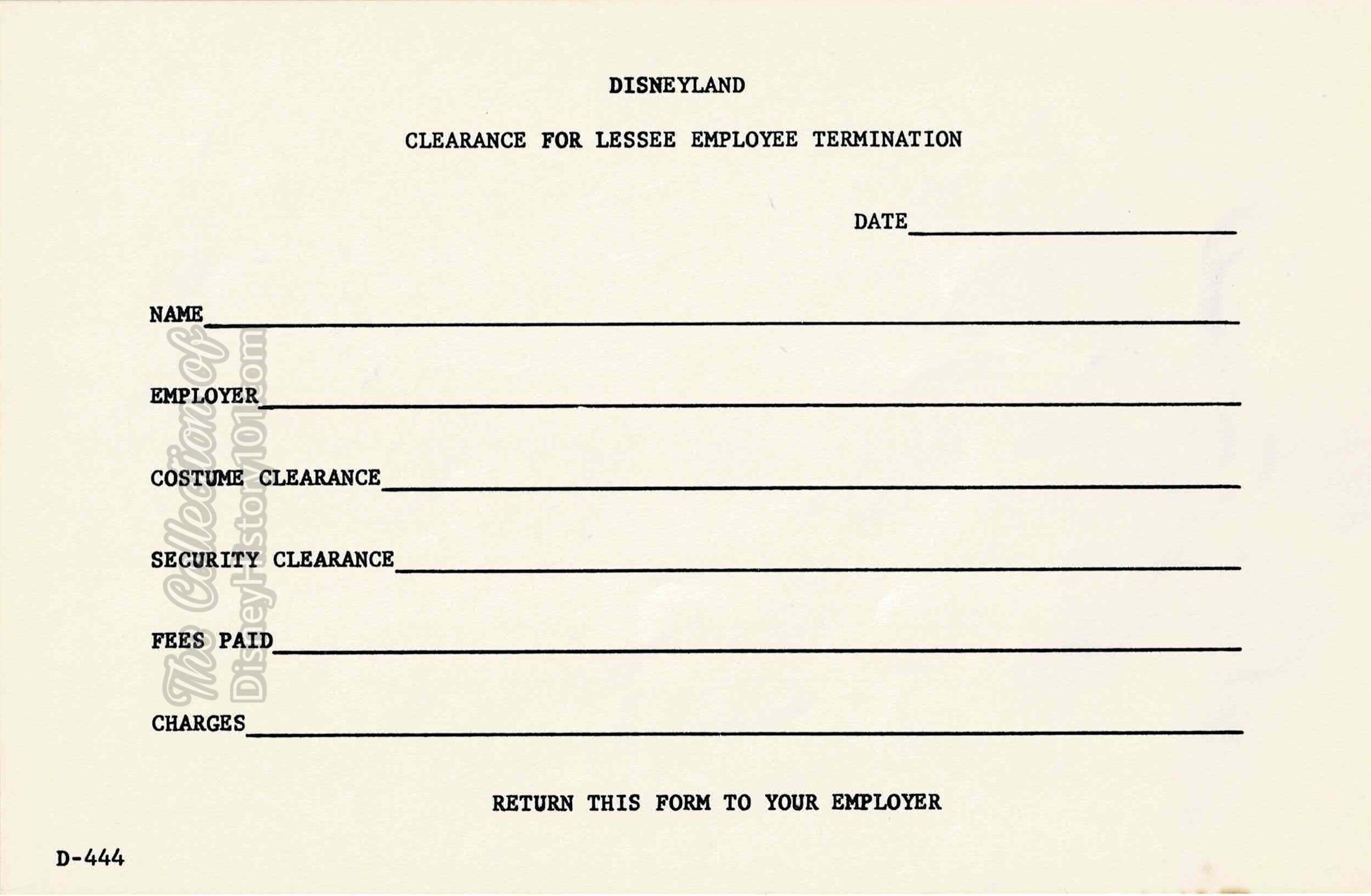
Con Agra’s Orville Redenbacher brand continued the official popcorn of Disneyland until new Disneyland Participant Diamond Foods’ (and Pop Secret) were brought aboard in 2015. The new Participant sponsor of Disneyland and Walt Disney World Resorts signed a multi-year deal which included the sponsorship of Fantasmic at Disney’s Hollywood Studios.

“MODIFICATIONS AND MAINTENANCE”
The Arcade Mechanics team regularly repaired the popcorn machines. David (a Disneyland Arcade Department “Electro-Mechanical Technician"), who worked around these carts between 1974 and 1998, shares some of the history of the antique Disneyland Popcorn Cretors :
“My knowledge goes back to 1974. I believe we had 6 or 7 wagons back then. We rehabbed each one every year over the winter months. Back then I watched the Arcade Department add sheet metal, rebuild, modify, and restore each wagon. I can’t say for sure that they were the same ones from 1955/1956. However, looking at all the early photos and knowing what we had in 1975, I believe they just kept upgrading the originals. I saw when they removed the old Cretors signage (original cast iron sign). The modifications always kept the original look, but made the wagons operate more efficient.
The early carts had no storage space…supplies on the ground in metal open boxes.” David adds that a “lower section [was] added so storage would be off the ground. I remember when we upgraded the wheels so they would hold the added weight of the modifications.
Each year every wagon was stripped of its sides exposing the angle iron frame. The parts were steam cleaned and primed to keep from rusting. The wiring would be improved to reduce ‘down time’. Oil storage and delivery was modified many times over the years. The sign shop would hand paint and letter the signage like new every year. I believe we probably fabricated additional wagons in-house and we also had a couple of wagons made in Japan by the company that made them for Tokyo Disneyland.
…As of 2019, the last ‘vintage’ red popcorn wagon still in operation, [was] currently in New Orleans Square. It [was] used as a spare when one of the new wagons needed work in the shop.”
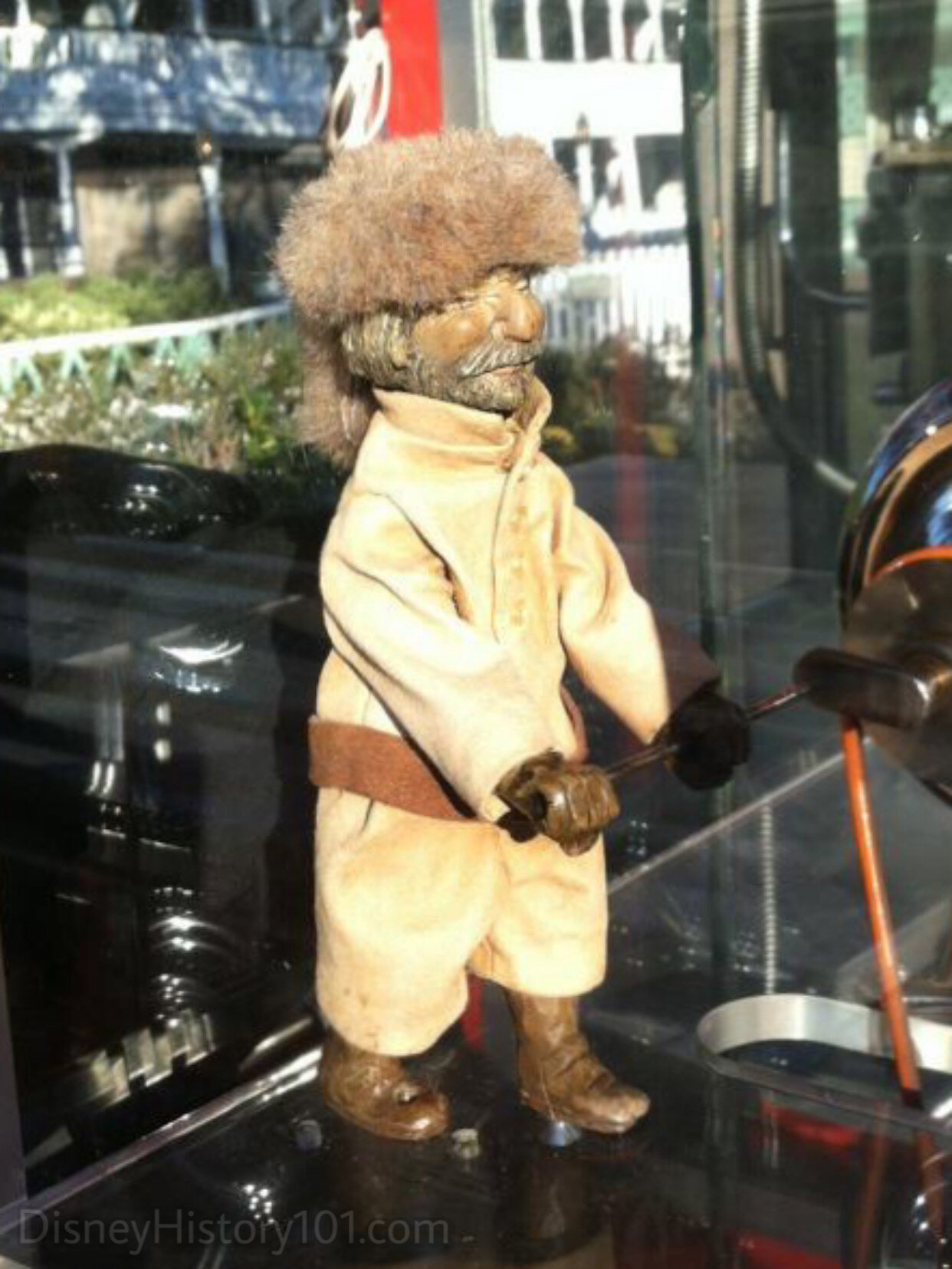
“CRETOR’S CHARACTERS”
The Cretors carts created tangible and delicious memories for Guests through Merchandise and Show!
By 1991, a team of six Disneyland Cast Members (comprised of the Audio and Costume Divisions) would check the Audio-Animatronics® figures to assure the current standards of Show Quality were met. The walk-through of this attraction and 14 other attractions (in addition to a few other locations like the Br’er Bar, which had figures), would occur some four-to-five hours before the Park opened. Oil stains were cleaned away, and rips and tears were repaired on the one-of-a-kind pieces of wardrobe belonging to some 700 figures. Meanwhile one costume (of three spares kept in cabinets of the attraction’s Backstage Areas) was used to re-dress the figure. Some of these figure’s locations pose a challenge for the Costume Division Cast Members.
As for character maintenance, David recalls :
“The animation was restored and put in a cabinet. Later the cabinets were replaced with ‘trophy cases’. Everything stayed in the old frames. The clowns were kept, and more were purchased over the years. They are probably still available. Costuming would sew replacement clothes [for them]. Though the lever-cranking figures have been altered to thematically match the land that hey inhabit, the Main Street Town Square Cretor still carries a clown figure as a nod to its origin!”
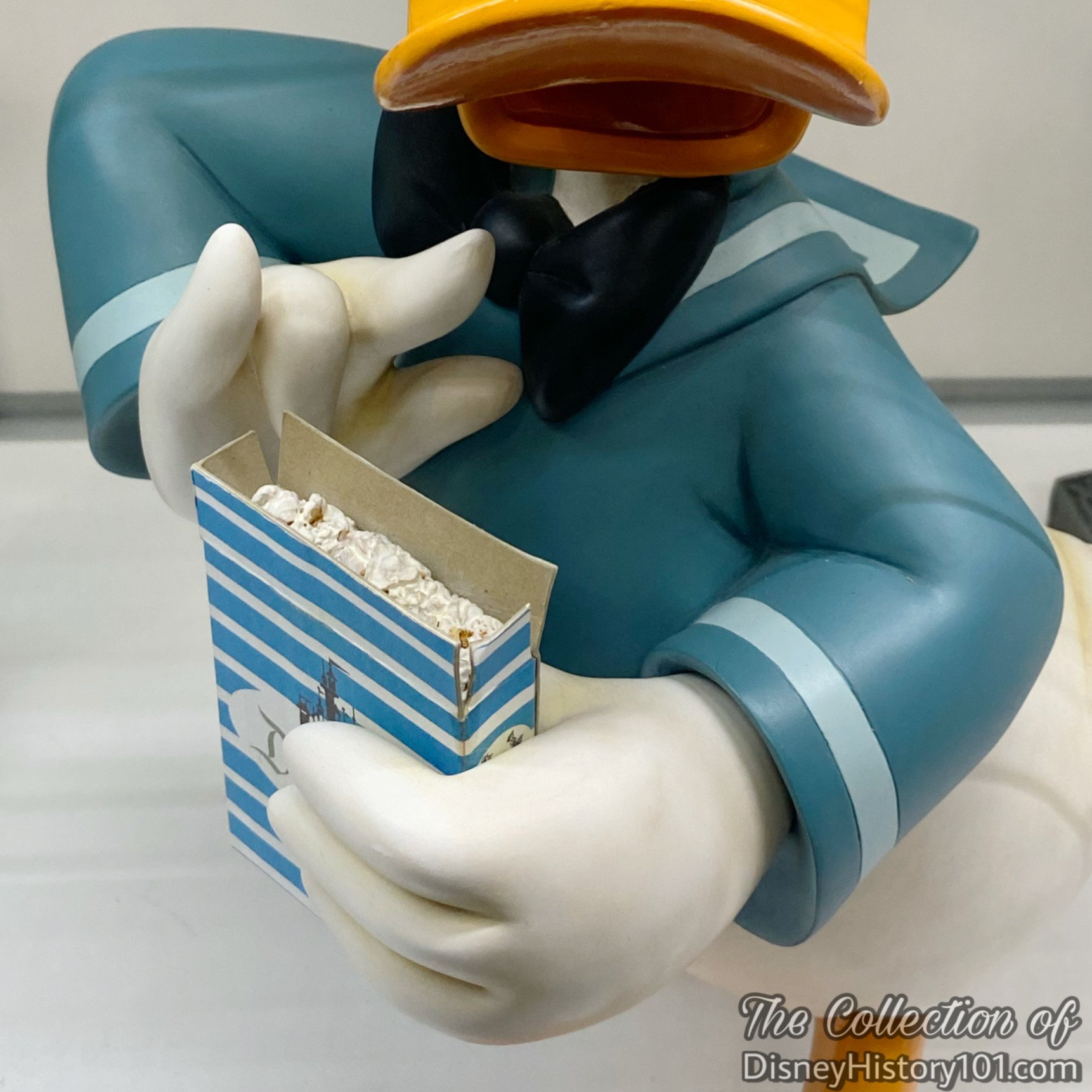
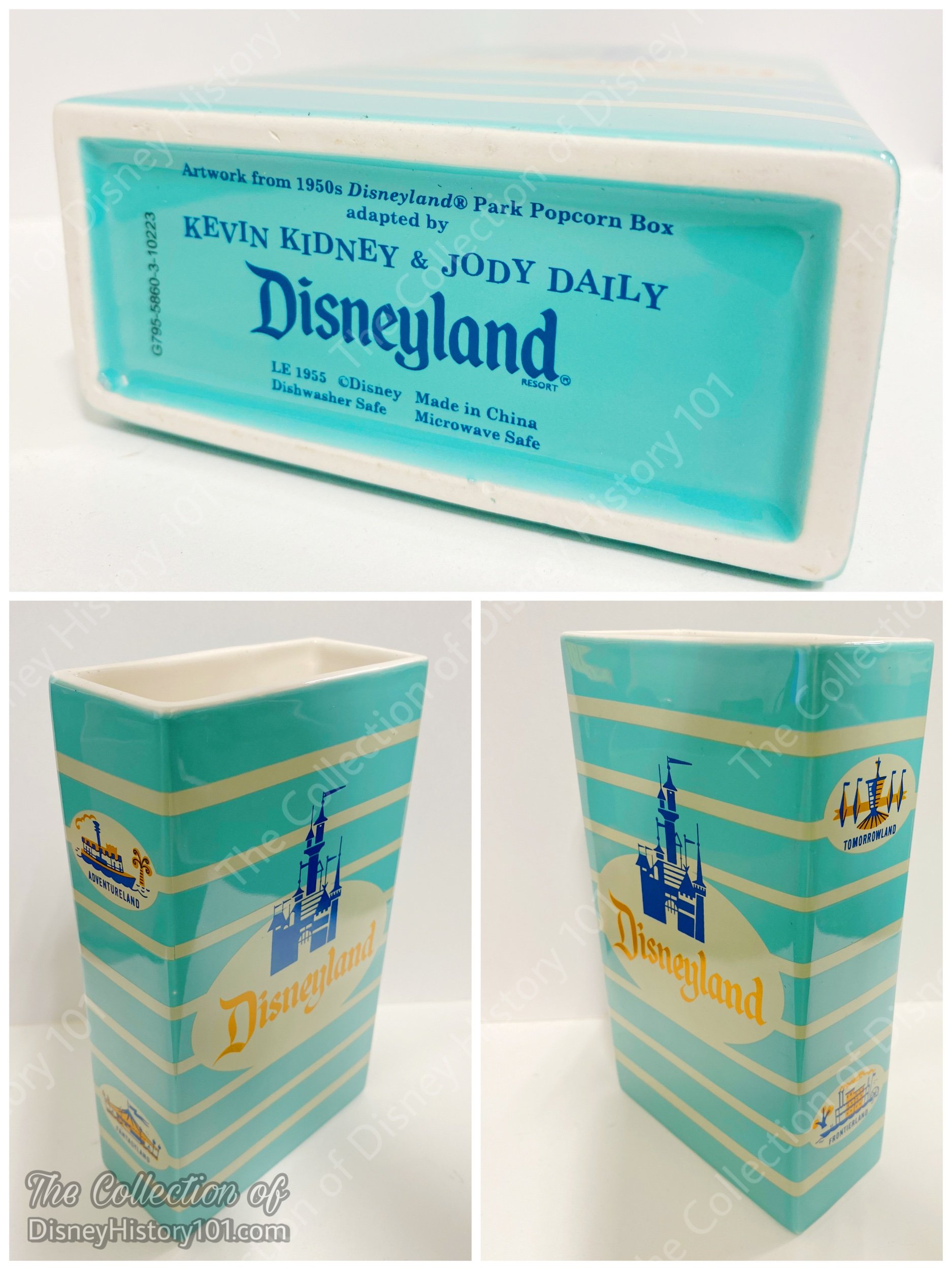
The 1950s box art was so memorable, that ceramic reproductions (by Kevin Kidney and Jody Daley) paid homage and were made available as a limited collectable for Disneyland’s 55th Anniversary in 2010.
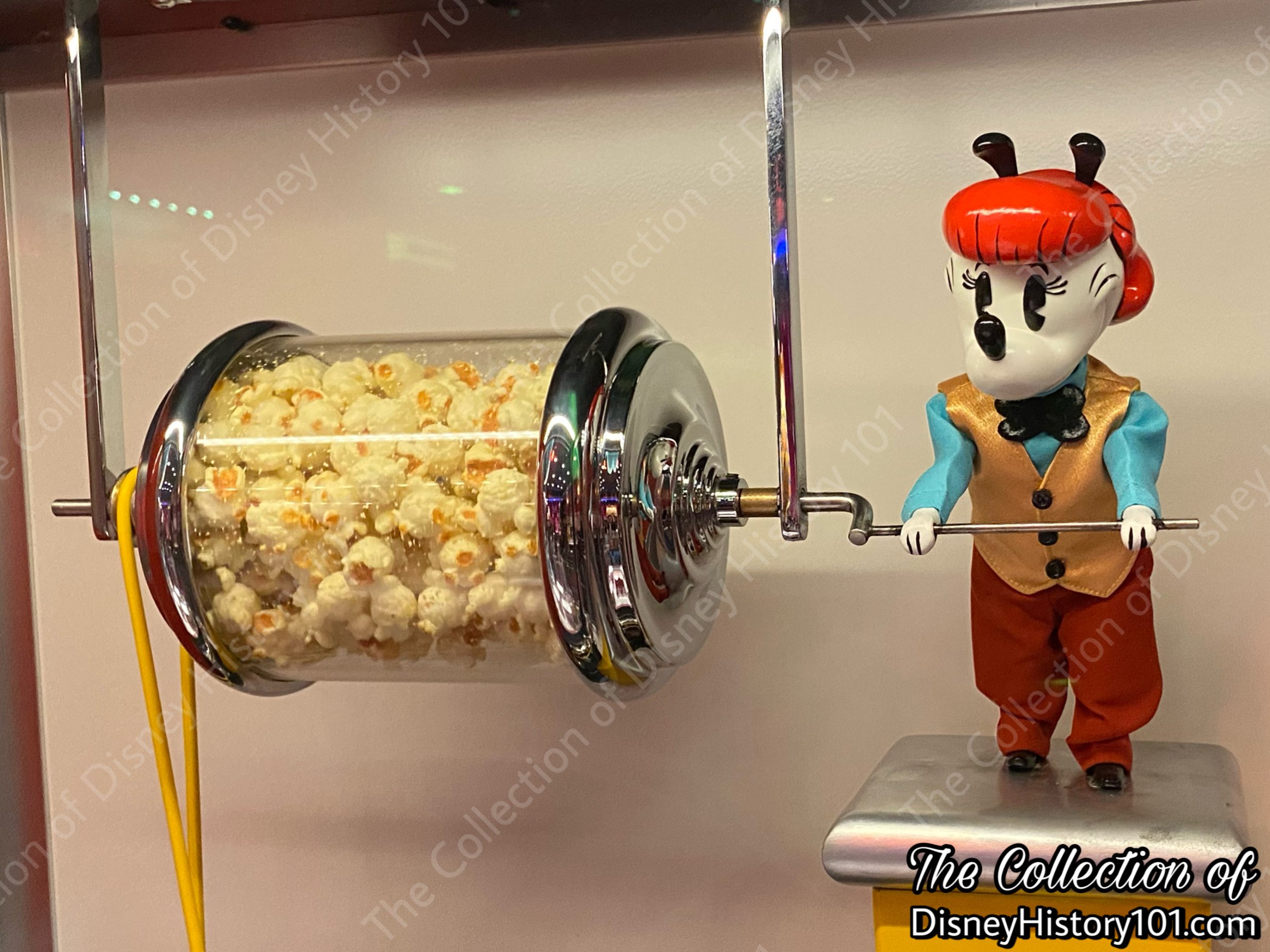
“Popcorn Cart Legacy”
The cart attraction has a legacy, “popping up” in areas of lands in Disney Parks worldwide. For instance, Hong Kong Disneyland has Popcorn Carts on Main Street, U.S.A., in Grizzly Gulch, Fantasyland and Tomorrowland.
The very concept of Outdoor Vending Carts continues to have a legacy through Disney Parks worldwide. Hong Kong Disneyland has Outdoor Vending Carts featuring Korean Squid, Turkey Legs, and Frozen Lollipops Presented by Dole.
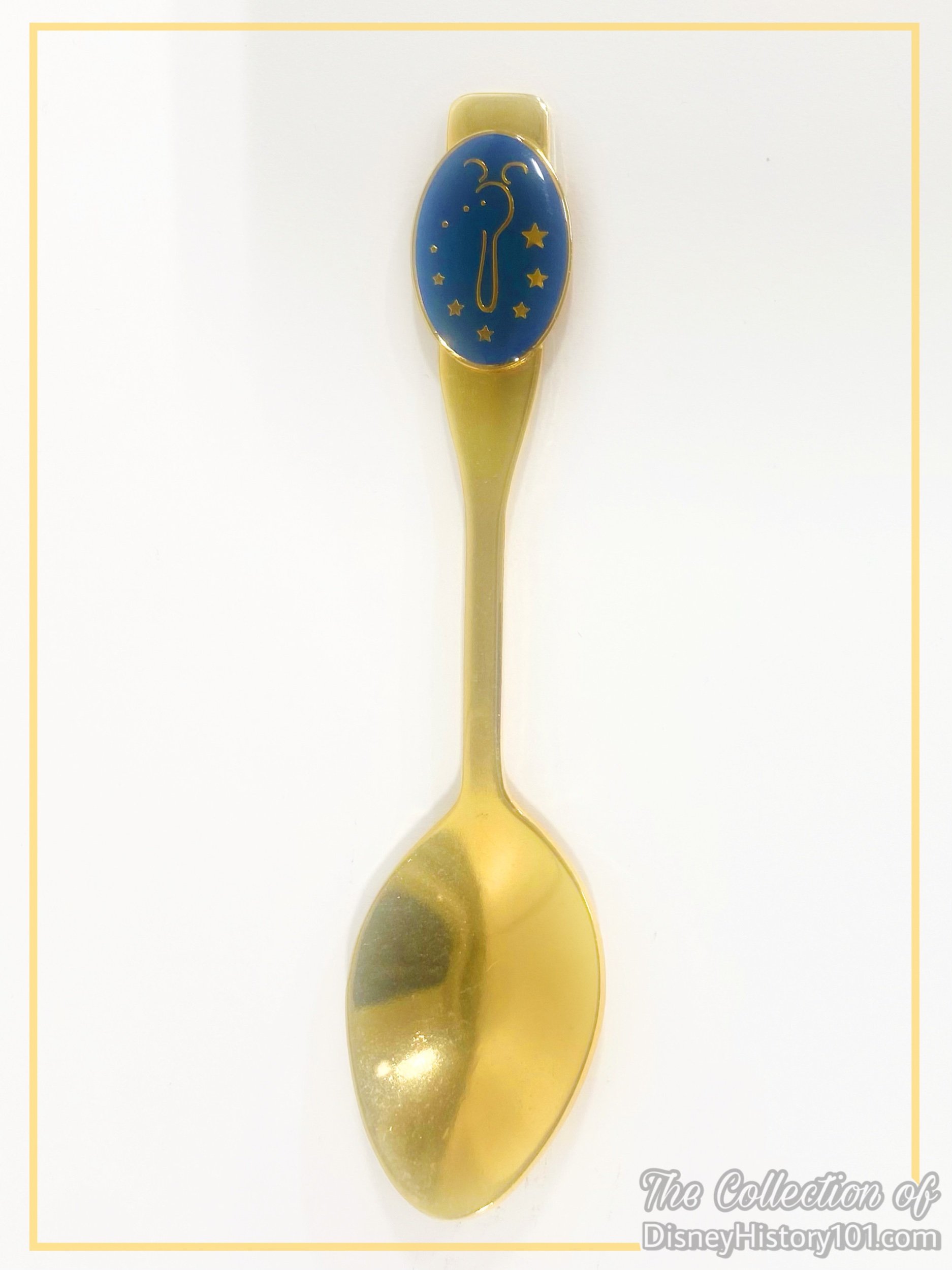
Today Outdoor Vending/Outdoor Ventures/ODV is the business unit responsible for selling popcorn, ice cream, balloons, etc., in outdoor locations. It’s called Outdoor Vending at Disneyland Park and Outdoor Ventures at Disney's California Adventure Park.
RAINBOW MOUNTAIN STAGECOACH RIDE (and CONESTOGA WAGONS)

At Disneyland there is a "story behind the story" of every attraction, every attraction is a living experience for the guest. Disneyland ride-through attractions or adventures have officially been defined as an “individual show, ride, or exhibit designed to produce an entertaining Guest experience. Disney attractions stir the imagination, enliven the senses, and provide the participants with positive, innovative entertainment, which is the essence of the DISNEYLAND Show.” It is important to review the story of the attraction, tell the story, explain it, and create interest. This is the story of Rainbow Mountain Stagecoaches.
“Horse-Drawn Coaches and Frontier America”
Since the early 1700s, coaches have transported Americans from place to place. In 1791, even George Washington toured 1,900 miles of the colonies in his White Coach. Before long, there were the (occasionally covered) stage wagons, or “mud wagons,” used for passengers and freight. The heavy Brewster Coach could transport many more passengers inside and atop.
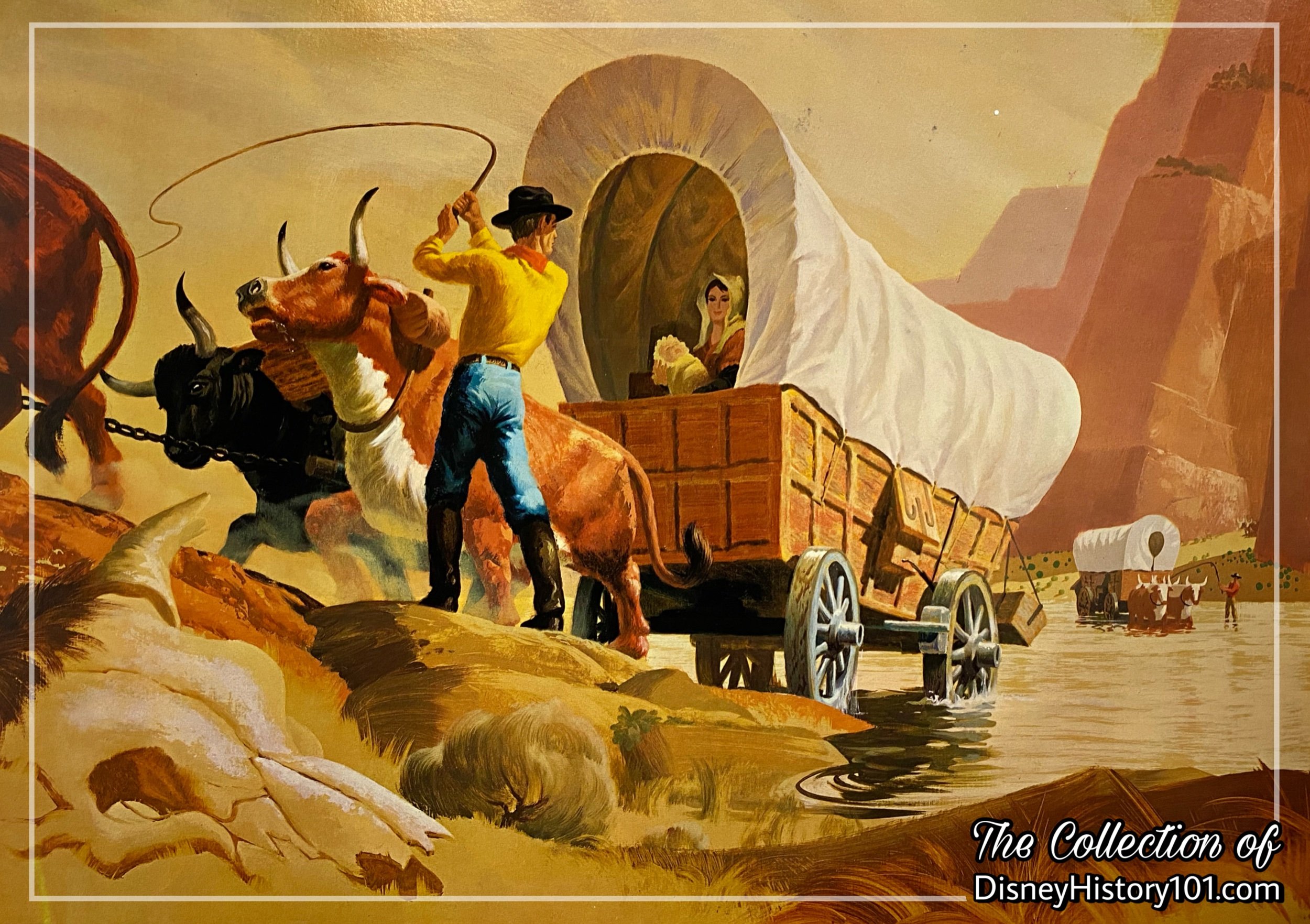
Soon, Conestoga, Pennsylvania gave birth to the Conestoga wagon, used to transport folks West along the Oregon Trail and Santa Fe Trail. “Many Americans, with everything they owned piled high in the back of a covered wagon, headed out to explore and settle the wilderness.” The Conestoga wagon could be pulled by a four or six-horse (or even oxen) hitch. While it was not so comfortable, the driver often walked alongside the vehicle, the Conestoga wagon got the job done, moving goods and people West. Not long after, the town of Concord, New Hampshire gave birth to the Concord coach. While the Concord coach was generally pulled by a team of horses, it much more luxurious, typically outfitted with comfortable seats, and even leather straps which acted as shock absorbers against the rough terrain. Both vehicles become the standard of transportation for some time across America by the time Horace Greeley uttered those famous words - “go west.” As for the Concord, it outlasted the Conestoga, and was used to transport passengers, mail, a strong box, and a man riding “shotgun.” In fact, a Concord stage line began to operate from Missouri to California, and a concord stage made the first transcontinental trip. And before the railroad replaced the Concord coach, a form of the vehicle was even adapted as a railroad car.
While the horse-drawn methods of transportation became archaic an outdated with the advent of the motorcar, a passion for horseback riding and equestrian sports persisted into the new century.
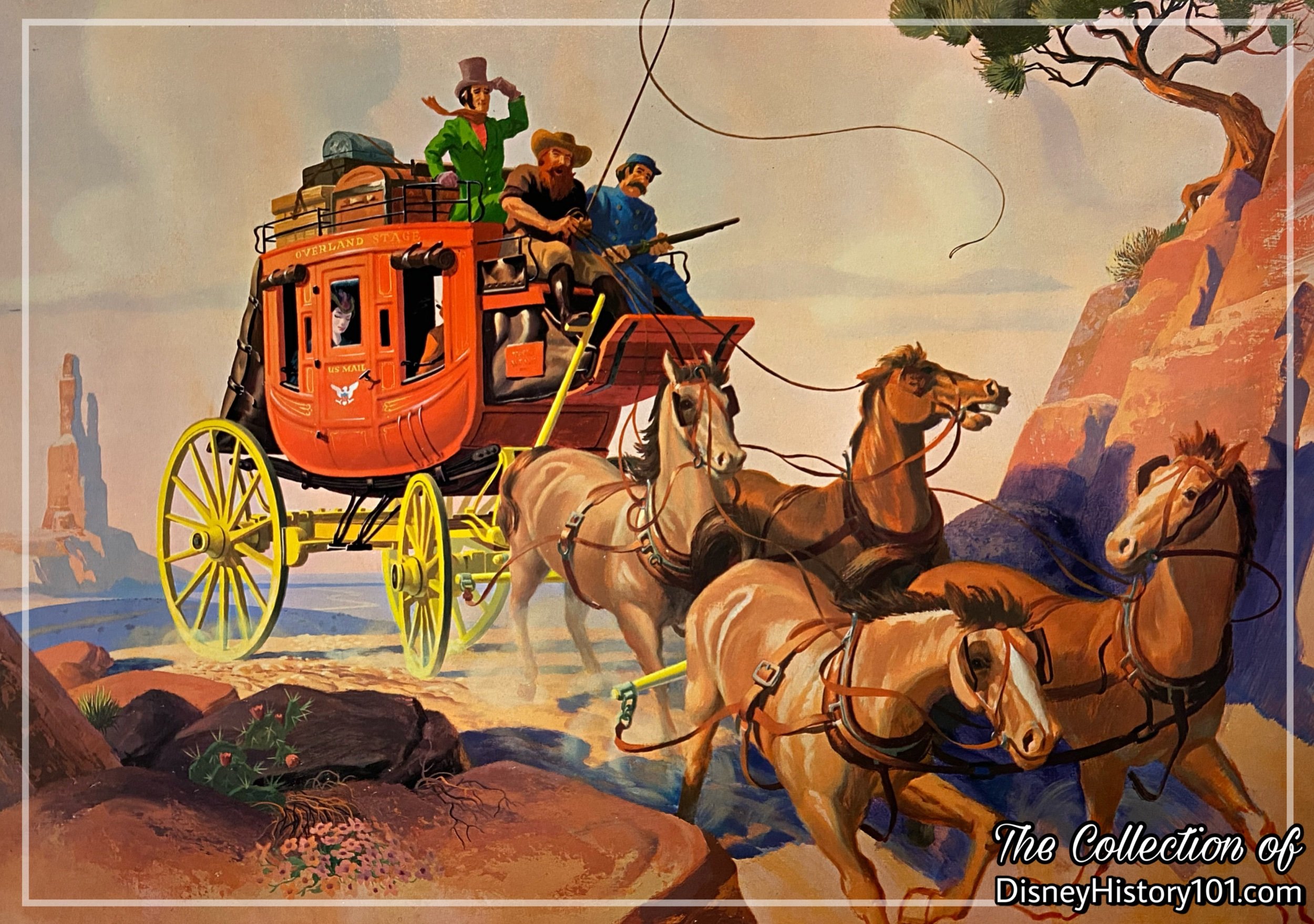
“Walt Disney & Horses”
Now it’s a fact that Walt Disney was one such person who had an affinity for horses! Beginning in 1932, Walt became an avid polo player with his very own Mickey Mouse Polo Team engaging at Uplifters and Riviera Fields. Walt even had a small stable of horses. Despite an untimely polo injury, Walt continued to ride horses along with the elite Ranchos Vistadores (a group of celebrities and prominent Californians who enjoyed equine), in the mountains of Santa Barbara just like true-life cowboys.
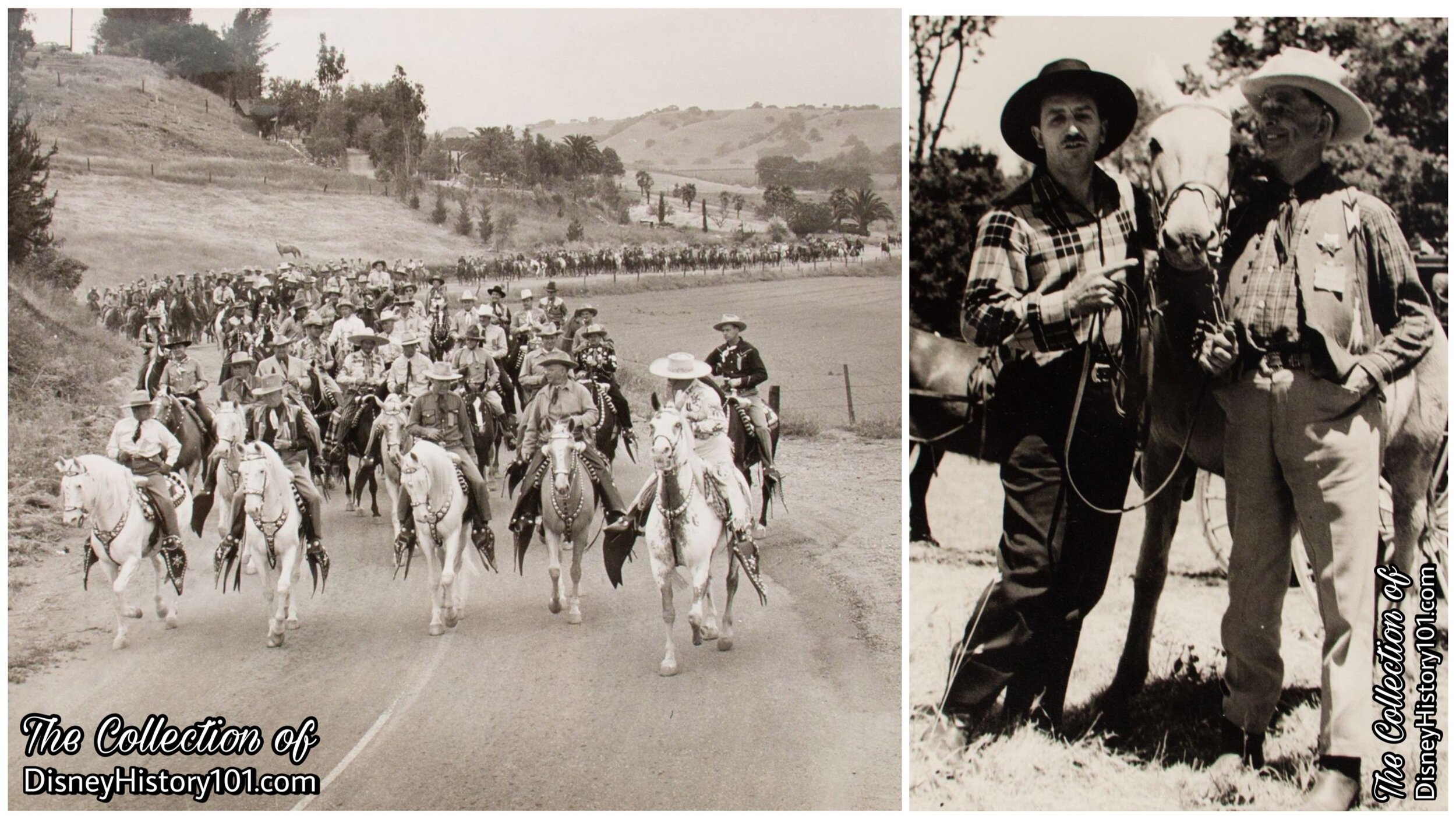
All the while, Walt Disney’s love for horses was evident as his studio produced a couple of live action films with equestrian-related themes a stars. Similar to Walt, Mickey Mouse acquired a couple of horse friends - Horace Horsecollar his plow horse appeared in early animated shorts and Tanglefoot appeared later in the comics. Many films featured horses, including Mickey’s Polo Team (released 1936), How To Ride a Horse starring Goofy (released 1941), Stormy the Thoroughbred Horse (released 1954) and The Littlest Outlaw (released 1955).
So, it wasn’t any surprise (to some Walt Disney Studio artists) when Walt began developing a few equestrian-related ride concepts among his earliest plans for a Mickey Mouse themed amusement park which first appeared on paper as far back as 1932.
“Blue Sky for Walt Disney’s Amusement Park Stagecoaches”
The Mickey Mouse Park Stage Coaches were perhaps the some of the earliest attraction vehicles to be both researched and developed. Yes, their earliest “stage” of development begins more than a decade later, on August 31, 1948, when Walt was dreaming about a Park (to be located across the street from the Studio in Burbank). Obviously, the fastest way to move people over the extended areas of Walt’s Park would be by utilizing moving vehicles. A memo was circulated among artists of the Walt Disney Studios, mentioning a “Horse-Drawn Carriage” attraction. It is clear that stage coaches were reckoned to be a part of the drawings and other plans for “Mickey Mouse Park” on an 11-acre plot of land (to be located near Griffith Park, in Burbank, California).

The excerpt (pictured above) is from an early artist’s rendering of the aforementioned “Mickey Mouse Park.” By the time that the project’s name was changed to Disneyland, the attraction’s story had begun to develop much further beyond what you see here, but the coaches were retained and featured on plot plans like “Disneyland Preliminary Scheme #1”.
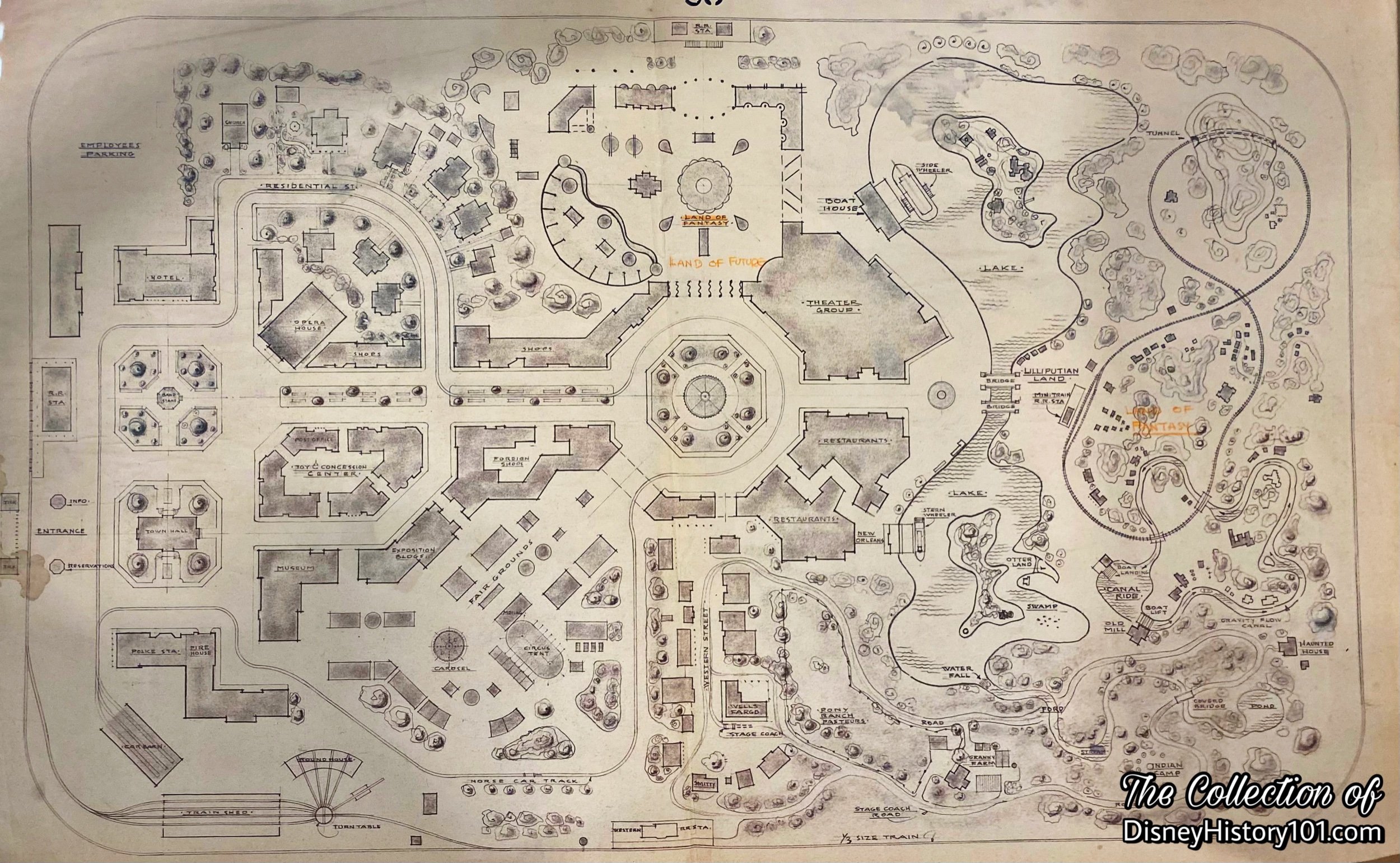
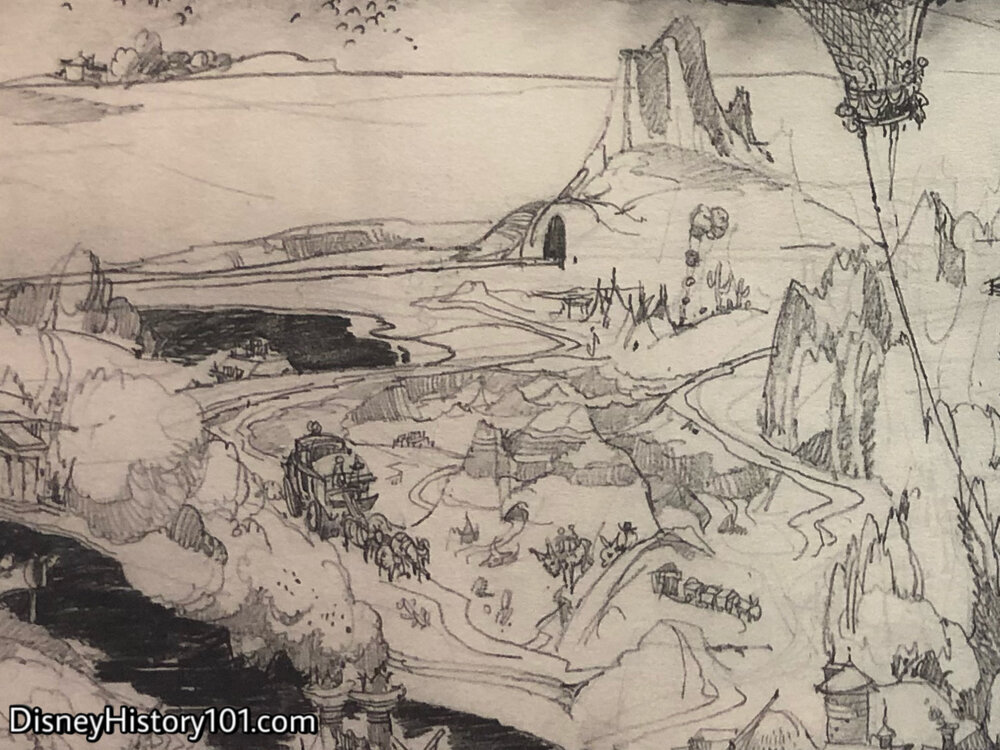
“Designing & Selling Disneyland”
While many artists contributed, the talented Herbert Ryman is of note. Herb had joined the Disney Studio in 1938, after Walt saw a public show of his work in New York. (Herb's paintings were being exhibited with those of another up and coming artist, Andrew Wyeth.) Herb Ryman acted as art director for such films as Fantasia and Dumbo, but had left Walt Disney Studios in 1946 and (by 1953) was employed by 20th Century Fox. Walt reached out to Herb and during one weekend (September 26 & 27, 1953) the first “Schematic Aerial View” over Disneyland originally produced!
After new economic research reports had recommended a final resting place for Walt Disney’s Disneyland, artist Herb Ryman had hand-inked, one of the original Disneyland concept drawings - “Aerial Schematic View” over Disneyland - between September 26th and 27th, 1953. Subsequently, his original drawing was copied, and hundreds of resultant drawings were made (some of them hand-colored), based on the original (with constant modifications being made, as Walt Disney’s “Disneyland” developed). An excerpt from one is pictured above, with the stagecoaches and wilderness trails clearly part of the plans (Marvin Aubrey Davis’ Plot Plan even labeled “Canastoga Road” and “Stage Coach Rd.,” implying separate trails for the vehicles). By this time, some of the vehicles of this attraction were briefly referred to as “Yellowstone Stagecoaches.”
But, what scenery lay in store for passengers of the Stage Coaches? It seems that many elements of drawings produced for the 11-acre Burbank plot were retained. Proving this is an early form of (what would come go be known as) the “Disneyland Prospectus” [prepared in 1953 for Disneyland Inc. by WED Enterprises], which reads : “Frontier Country….where the Stagecoach meets the TRAIN and the RIVERBOAT for its trip down the river to New Orleans…Ride shotgun on the STAGE COACHES…past GRANNY’S FARM, a practical working farm operated with real live miniature horses, cows, oxen, and donkeys…through the pine forest, fording streams into Indian country and through the Painted Desert.”
“The Painted Desert” (the name used to identify this region during 1955), appeared on the “Proposed Diagramatic Layout of Disneyland” (Marvin A. Davis’ plot plan, produced for WED Enterprises, by September 12, 1953) that was shown to potential investors as early as 1953. According to “Disneyland” (prepared for Disneyland Inc. by WED Enterprises, 1953), “Ride shotgun Stage Coaches…past Granny’s Farm, a practical working farm operated with real live miniature horses, cows, oxen, and donkeys…through the pine forest, fording streams into Indian country and through the Painted Desert.” However, it seems (as depicted in the drawings) that it was only meant to be traversed and explored by way of a Stagecoach or Mule Train. The “The Disneyland Story” describes the scenery of the “Painted Desert” this way : “As you go into the Painted Desert you will pass the Indian encampment, go through a Pine Forest, and Ford a stream. When you get to the Painted Desert you will see the things you usually find there, such as the beautiful cactus plants, trees, probably the water hole with the ‘poison sign’, the skeleton of a steer, and other appropriate dressings of the desert. As well as the stage coach ride, you will be able to take the Conestoga Wagon and Mule Pack ride into the Painted Desert.” Later, another early document describing Walt Disney’s Disneyland included that of a “Stage Coach Ride.” So it seems (at least for a brief period), that the Conestoga Wagon (and not a Mine Train or Stage Coaches) were considered as options to explore the highroads and byroads of the Painted Desert in Frontierland.
On December 3, 1953, Walt wrote his sister Ruth Beecher: “Our DISNEYLAND project is getting nearer an actuality all the time and I'm anxiously awaiting the time when it does get under way. In the meantime we are gathering up all sorts of things for our exhibits. We have… about thirty miniature ponies that we keep out on the back end of the studio lot, with most of the mares in foal. Then there are three stage coaches that we made here at the studio - they're real beauties, painted in bright red, with gold trimmings. We're all very excited about this project and feel It will be a wonderful thing for everybody.”
Meanwhile, viable project Concepts (as seen above) featuring stage coaches, were supported by a well-developed business case and built expectation. These were carried to potential investors back East. Frank Pfannenstiel recalled how Walt was preparing to ride one of his horses when he received important news: “I was getting Walt's horse saddled, when Roy came over and put an arm around Walt, saying, ‘I’ve got the money, let's go to work.”
By September 16, 1954, Walt excitedly wrote to his sister Ruth Beecher in Portland, Oregon, briefly describing Frontierland and its stage coaches and “prairie schooners” (another term for Conestoga wagons): “We are very busy here at the studio, what with the television program and getting our DISNEYLAND Park under way, we’re knee-deep in work. The Park is scheduled to open in July of next year. It will be a miniature world’s fair idea. There will be trains, river boats, prairie schooners, fantastic rides, etc., etc… FRONTIERLAND… will be of the gold rush period, with Indians, Buffalo, Stage Coaches, etc.”
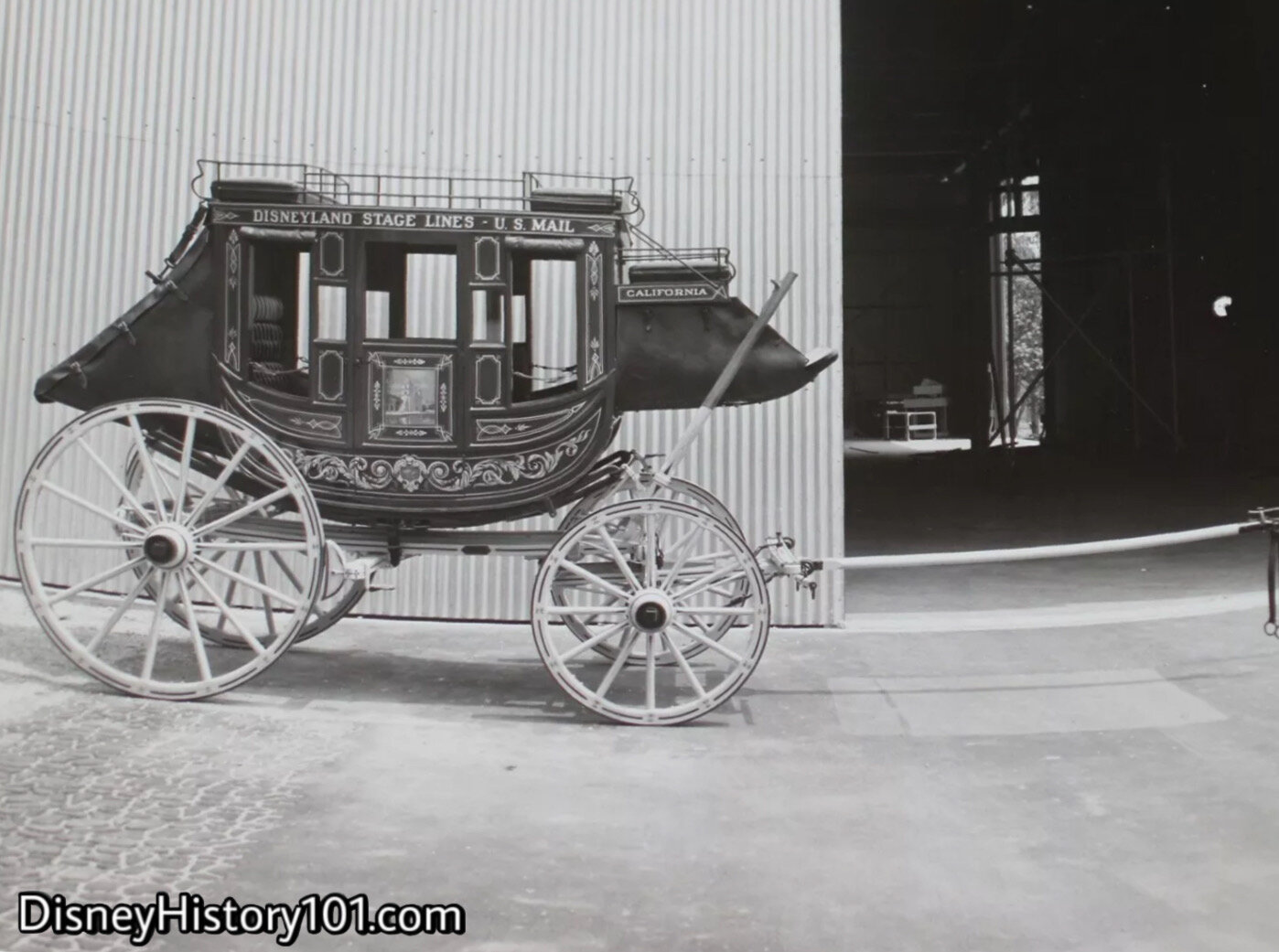
So while alternative modes of desert transportation were “on the drawing table,” the Disneyland Stage Lines Stage Coaches were perhaps the earliest of Disneyland’s attraction vehicles to be researched and developed. As aforementioned, their story actually begins in 1950, when Walt was toying with the idea of a “Mickey Mouse Park.” About this time (in 1951), a couple by the name of Owen and Dollie Pope (who had previously manufactured horse trailers in Fort Worth, Texas) was running an equestrian show at the Pan Pacific Auditorium (in Sacramento, California), and Disneyland production artist Harper Goff attended. Harper recommended their show to Walt, who was subsequently so impressed with the showmanship and their ponies that he arranged a meeting with the couple during the spring of 1951. The idea was to get their assistance with “putting together some livestock for his future park.” After some negotiation and throught, the Popes (Owen and Dolly) were ultimately persuaded by Walt Disney, under the offer that he give him room and board. So Owen and his wife Dolly were hired by Walt Disney. This happened on the Sunday after Thanksgiving in November of 1951 - four years before Disneyland opened its gate to the public.
It is important to note that the “Proposed Diagramatic Layout of Disneyland” (Marvin A. Davis’ plot plan, produced for WED Enterprises, by September 12, 1953) mentions three equestrian rides in “Frontier land” : (1) a “Pack Mule Ride”, (2) a “Stage Coach Road” for Stage Coaches, and (3) a “Pony Ride” next to a “Corral.” All of these massive projects necessitated Owen and Dollie living on the Walt Disney Studio Lot for the duration of their development. Both Owen and Dollie supervised the fabrication and built the original four (what would become to be known as) the Disneyland Stage Lines Stage Coaches during 1954. The three “80 percent” scaled-down stage coaches (named after the states of California, Arizona, and Colorado), were designed and developed to be drawn by a “six pony hitch” of a miniature breed of midget horses, ponies, and Sardinian Donkeys.
“Breeding and Training Stock”
Now it has been said that “a cowboy needs a horse.” To meet this need, Owen and Dollie also oversaw the breeding, care, and training of these animals, most of which were intended for “Frontier Land, which is Disney’s favorite section of the fair,” according to Loius Berg (Reporter for “This Week Magazine”)! Louis Berg had the privilege to tour the Walt Disney Studio “stud farm” late in 1954, when he divulged : “I visited the stud farm where the midget horses, ponies, and Sardinian donkeys that will draw the wagons, carts and surreys are being nursed. And it’s a sight in this world to watch the tiny foals nuzzling up to mothers themselves no bigger than a normal foal. Disney knows every colt and every pony by name, and can tell you the characteristics of each of the several hundred animals : one likes to chew on cigarettes, another is a brat. ‘Get away, General,’ he said to a young colt that was biting his trouser leg affectionately.” While many of the other 5/8-scale ponies would become known to Park visitors at the time of their big debut to the public during Disneyland’s Opening day Parade, one (often famously seen pictured with Walt Disney) was born at the studio. “‘We call him ‘General George’ because he was born on George Washington’s birthday,’ Disney explained,” to Louis Berg. Herb Ryman [in “Work With Walt” by Don Peri] recalled how Walt “loved the the little animals - the little horses, ponies, and mules.” You may have seen a few images of Walt welcoming the new arrivals - foals, colts and fillies born at the studio during this era. As a sidelight, Walt even rode horse in one of Disneyland’s parades alongside Davy Crockett. Columnist Louis Berg continues : “Incidentally the pony corral is the favorite of Disney employees and their children. Most constant visitor is ‘Bunky’ Thompson, receptionist, who spends lunch hours feeding the animals.”
An insert which accompanied area newspapers mentioned how “Disneyland stables were turned into a nursery tem-porarily, with nine mares expecting the stork before Disneyland's opening day, and five colts having arrived after the move to Anaheim from the Burbank stables. More than 200 ponies are working in the park.”
In addition to feeding, the equine were trained. Van Arsdale France once wrote: “He [that is, Owen] was worried about the horses ‘spooking’ with all the sights and sounds of Disneyland. So, a recording of sounds from arcades and shooting galleries, and yelling kids made up. This was used as an audio aid for horse training. Since the horses were not directly on the payroll, they had to be carried as assets. All were given names. They all received names of people in accounting. Lucy Cotton, for example had a mule on the records named, ‘Lucy Mule.’”
Concord Stage Coaches were not commonplace in the typical society of 1951. After “Museum authorities devoted their knowledge and skill to the accurate reproduction Conestoga wagons, Concord stages, [and] Western Buckboards,” it was deemed a requirement that certain arts and crafts were resurrected in order to fabricate the hubs, wheels, thoroughbraces, and other parts. One of the main crafts that was revived, was that of the wheelwright - the art of making wheels like the pioneers of frontier America! Studio Craftsmen had to heat the metal rim to the exact temperature, then fit and cool it, without scorching the wood. “Because of the great number of guests carried, the wheels are more sturdy than those on most of the catalogue models - another safety factor built into the attraction”, states one Disneyland Operation Manual. As a final touch, small details like the pin-striping on the wheels and stenciled letters were completed on the Walt Disney Studio backlot, by sign painters. According to Park historians : “One of the artists working on the coaches took issue with Walt about all those details. ‘People aren’t going to get this. It’s too much perfection,’ the artist said. With his disapproving eyebrow raised, Walt responded, ‘‘Yes they will. They will feel good about it. And they will understand it’s all done for them.’”
“In 1954, Day Sechler [sic] went to the STUDIO, where he helped Owen Pope make street cars, surreys, stage coaches and even a fire engine.”
Charley Brock recalled: “I had an older brother who was helping to build Disneyland and the Mark Twain. One day he came to see me and said that there was goin' to be a lot of horses at Disneyland. He told me to put on a clean shirt and overalls, and come with him. I saw Owen Pope and started workin' in the barn, gettin' horses and stage coaches ready.”
It is perhaps around this time that Walt Disney Studios animator Willie Ito (hired June 1954) recalled wandering onto the back lot and, in one of the workshops, seeing “large molds of the Dumbo ride, miniature trains, stagecoaches, huge blueprints on the walls, etc. It was teaming with activity.”
Walt was personally interested and involved in his Stagecoaches. About this time Louis Berg (of This Week Magazine published for September 19, 1954) wrote: “And into this dreamland, Disney has already escaped. If you want to see him nowadays, don't look for him in his office. Seek him out in the workshops. Like as not, he'll be polishing a wagon tongue for one of the stage coaches… In the carpenter shop, Owen Pope one of the last great wagon builders, was putting the finishing touches on a stagecoach - there will he four of them - scaled down 80 per cent from the Deadwood model.”

The horseshoes of the hoof-branded Belgians, Clydesdales, Percheron, and Shire-Percheron cross-breeds were made of rubber (to generate the “clip-clop” sound on Main Street). However, the horseshoes of the Frontierland equine (mules, Sardinian donkeys, midget horses and ponies) that travelled through unpaved areas were made of iron metal, the old fashioned way.
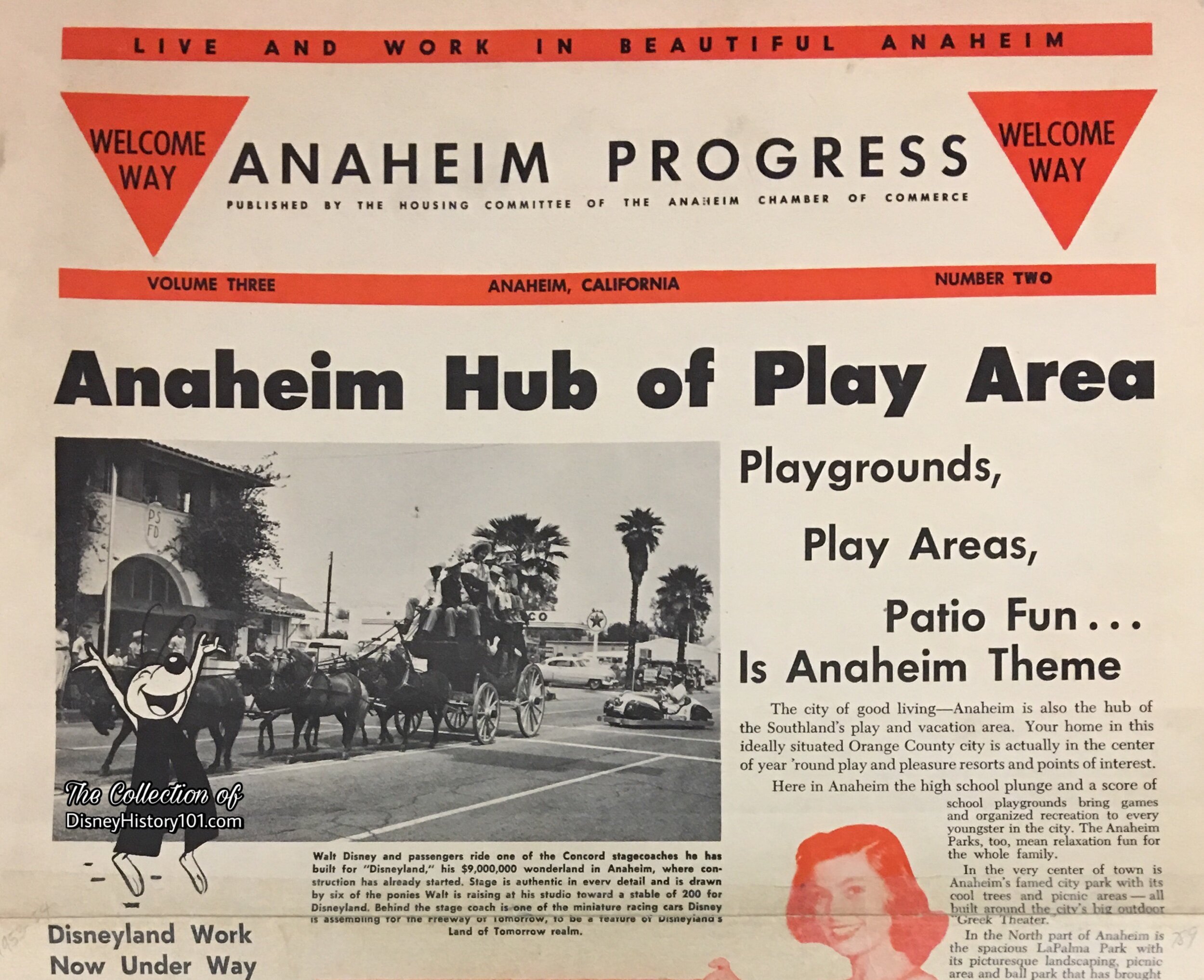
When at least one of the scaled-down Disneyland Stage Lines Stage Coaches was complete, Walt was so proud of it! Louis Berg (“This Week Magazine” Reporter), noted (by September of 1954) that “one of these coaches is already finished, and when Disney is in good humor, he’ll drive visitors in it though his grounds, handling the reins like Deadwood Dick.” Walt invited almost everyone to step aboard his new Stage Coach. The six-and-a-half-foot-tall Claude Coats recalled “Walt and a driver were giving rides around the lot, but he wouldn’t let me get in. He said I spoiled the scale.” Walt even took one completed Stage Coach down to the location of his former vacation home and “laughing place” in Palm Springs, for the Desert Circus (an annual springtime Palm Springs parade and community event). This was (of course) great pre-opening day Disneyland promotion, and resulted in Walt acquiring a few sponsors (through his former neighbors at Charlie Doyle’s Smoke Tree Ranch).
Now, by the time Disneyland was in development, Stage Coaches were not unheard of by area residents of Orange County. After all, Walter Knott had his Butterfield Stagecoaches and his Overland Southern Coaches running through Wild West routes of his own Knotts Berry Farm! So, part of what would set Walt’s stagecoaches apart would be their setting - the aforementioned “pine forest, fording streams into Indian country and through the Painted Desert.”
By July 1, 1954, George Whitney of Disneyland, Inc. directed Amusements, with Ron Miller overseeing analysis, philosophy, capacities, planning, operator training, and amusement procurement.
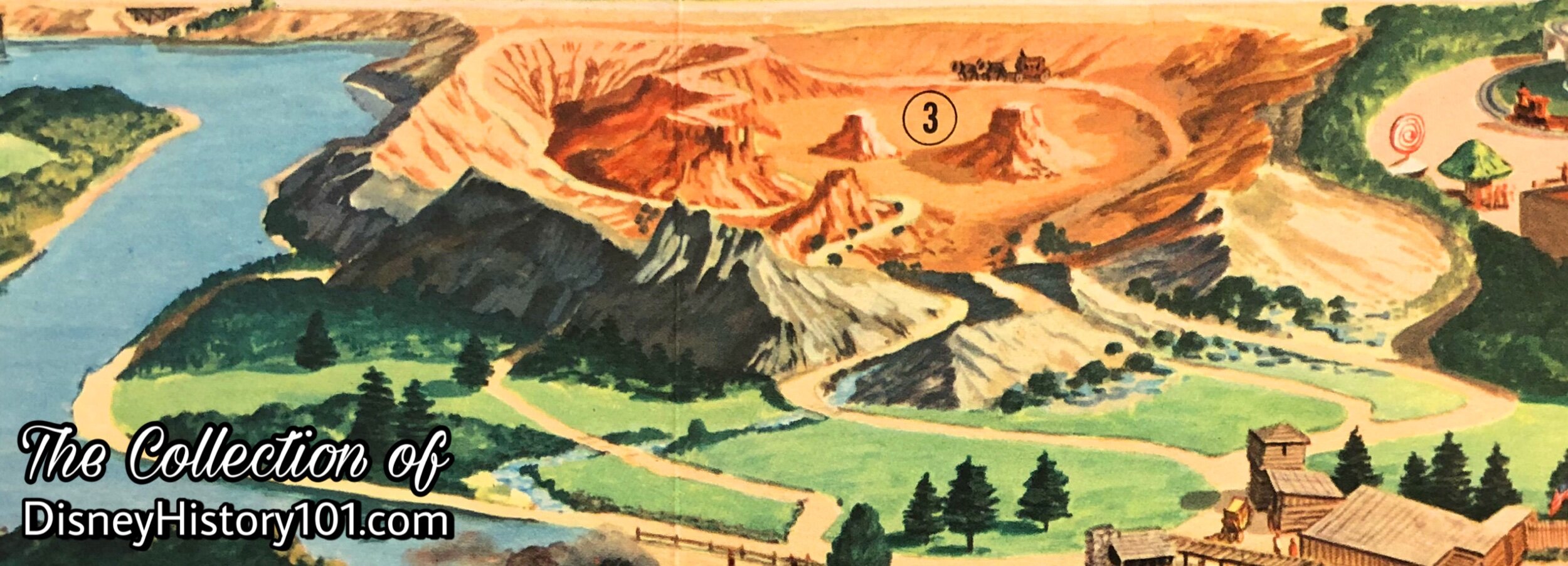
“Stagecoach Roads Construction and Landscaping”
Fortunately, Disneyland was constructed with enough space for the expansive area that would become Frontierland. As to the “greenscape,” it began to take form when Bill Evans helped save a number of orange trees along the route of the Conestoga Wagons, according to “Creating the Disney Landscape - An Interview with Bill Evans,” published in The “E” Ticket, Spring 1966. Walt continued to oversee the progress of the other Stage Coaches, according to Look Magazine (November of 1954). “As construction progresses on the Park, no detail is too picayune for Walt Disney’s attention. He bobs in and out of the workshops almost every day to check on the accuracy of the scaled- down stage coaches.” Walt also drive a jeep (at least on one occasion, as it “bounced over a stagecoach trail which will lead through the Painted Desert and along a river,” (according to one construction-era Bob Thomas article). Meanwhile, the finishing “natural” touches were being added to Disneyland’s own true-life desert, in Anaheim, California. Even before Disneyland opened, Walt’s friend (and Hollywood columnist) Hedda Hopper divulged, “Had a sneak preview of Disneyland…It was the planting that awed me. Walt bought $400,000 worth of trees and shrubs ; he depleted our nurseries and is now importing trees from Santa Barbara and San Diego. Cactus from Arizona already dots Disney’s painted desert”. [“Disneyland Park Found as Fantastic as Its Creator”, Published in “Looking at Hollywood”, May 22, 1955]. As for the outcome, the author of “Disneyland World of Flowers” reminisced about the greenscape: “If you were an early visitor to Disneyland you will recall a stage coach and Conestoga wagon ride that departed from this same area and carried the traveler through pine-covered country, a sun-baked desert, and back along the tree-lined river shore.”
All of this work was performed by the team of Jack and Bill Evans, under the direction of female architect and landscaper Ruth Shellhorn (to whom much of the Park’s original plant and tree selection is credited). This early piece of artwork (pictured above) was included inside the Disneyland Musical Map by Mattel - a mail-away preview of Walt Disney’s Disneyland, and perhaps one of the first pieces of licensed Disneyland merchandise. Those who purchased this c. 1954-1955 Disneyland promotional item could view the many roads (fit for wagons) coursing through the hills and desert of Frontierland’s Painted Desert!
As of June 2, 1955, C.V. Wood Jr. sent an Inter-Office Memorandum to Walt Disney regarding the best estimates that could be obtained at the time regarding the completion status of individual sections of the Park and Opening Day. C.V. wrote: “Wagon Rides: Okay. We still need design decision regarding some of the things you will see on the ride.”
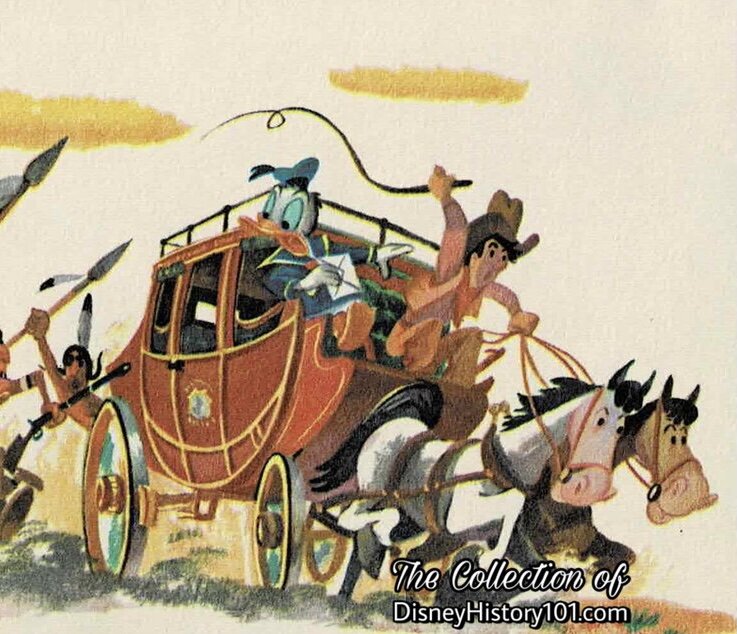
Though the conestoga stage coach looks different from Owen Pope’s final products, contemporaneous licensed Disneyland merchandise tantalized future guests, by granting these potential visitors a preview of Disneyland adventures.

Soon one authorized “Disneyland Information & Nomenclature List” (prepared by Bill Cottrell of Disneyland Inc., by May 25, 1955) divulged the details of “Disneyland Stage Lines” to Disneyland, Inc. employees. The three Coaches (California, Colorado, and Arizona) were to have a “4 horse hitch per stagecoach,” while the related Conestoga Wagons attraction consisted of “2 wagons” with a “6 mule hitch per each wagon.” In addition to these, the same documents mentioned “other wagon rides” which included the “Disneyland Transportation Company” or “Yellowstone Coaches,” - “3 Coaches - 4 horses per. each Coach.” There were also to be “3 Surreys - 1 horse per Surrey, 1 Buggy - 1 horse hitch, 3 wagons - 2 horses per wagon, and [sic] 4 Wagons - 2 horses per wagons.”
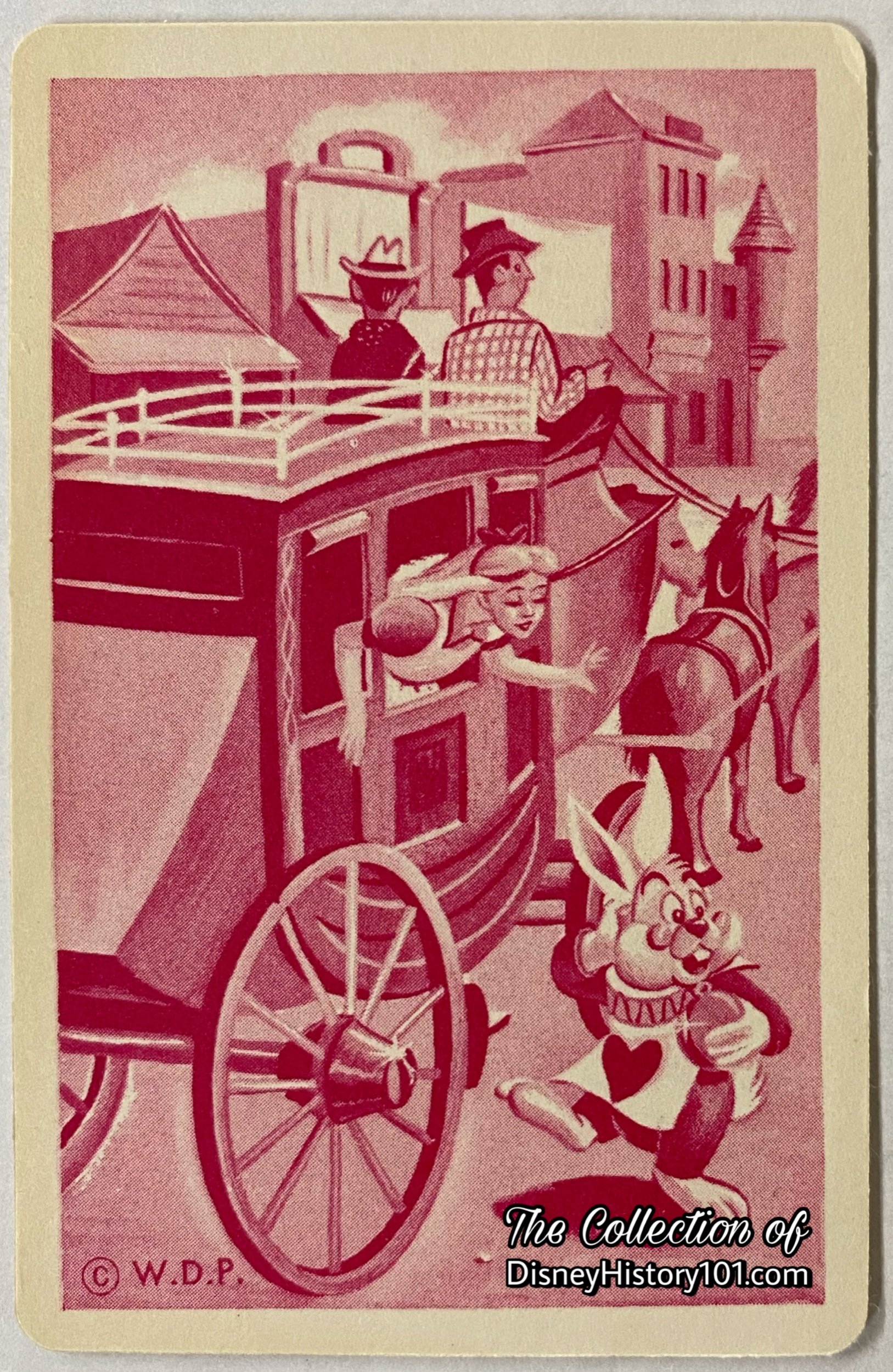
"She's late, she's late!" exclaimed the White Rabbit checking his big watch. "Don't you know the Queen's never on time!" explained Alice. "Let's take our ride across Disneyland's Painted Desert without her. "Oh me, oh my!" replied the Rabbit. "I was supposed to meet the Queen yesterday! I'm the one who's late!"
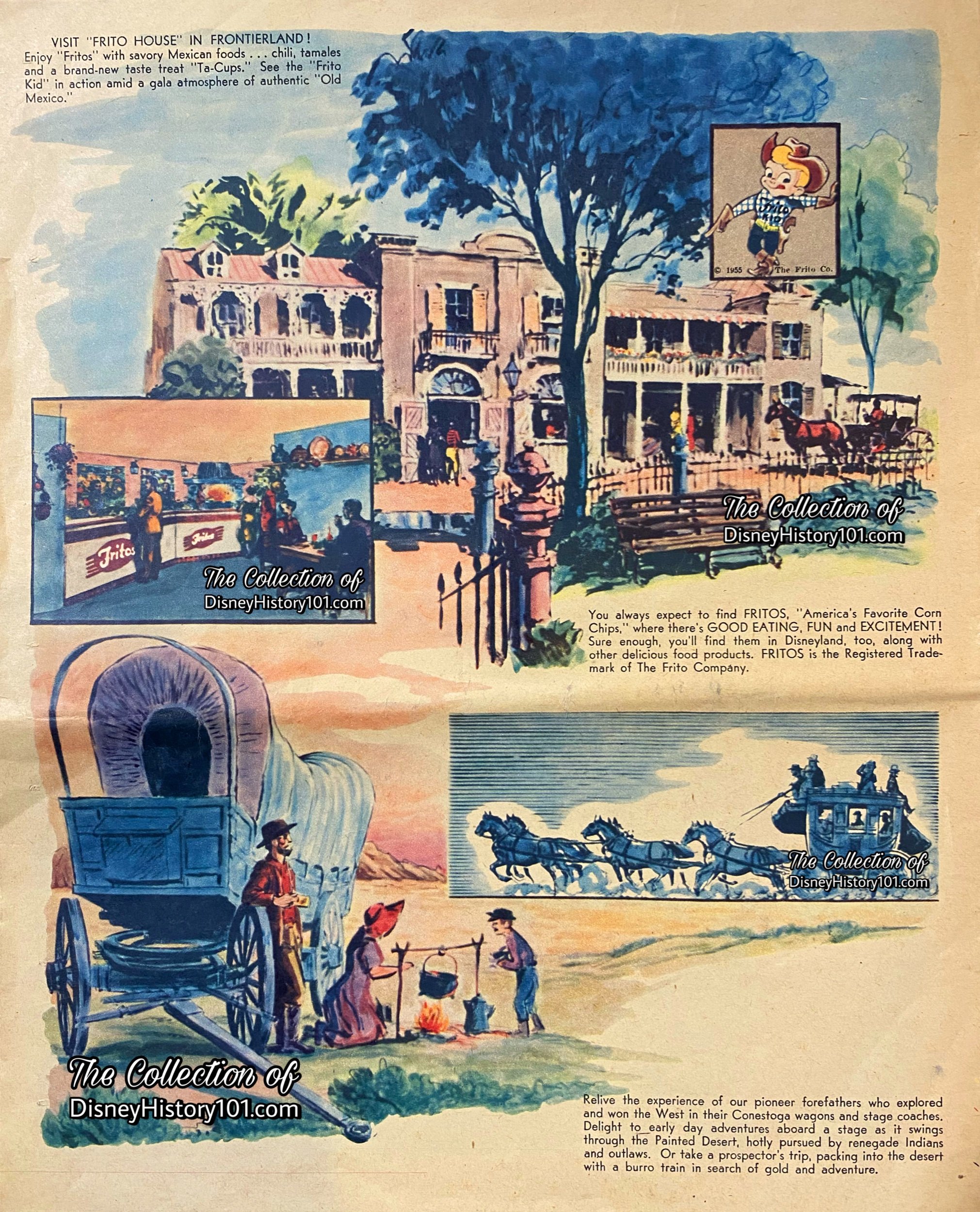
Disneyland’s horse-drawn vehicles made the news in many publications even before they hit the Frontierland trails. Panorama magazine (published spring of 1955) mentioned that “Buckboards and Conestoga wagons carry visitors to a Wells Fargo station for a stage-coach trip through the Painted Desert.” The pre-opening “Go Santa Fe to DISNEY-LAND” brochure printed sometime between July 4 and July 18 mentioned Conestoga Wagons, Surreys, Buggies, Buckboards, and Disneyland Stage Lines (3 stages and a four horse hitch) among the rides to open.
Day Sechler recalled: “Trying to get ready for Opening Day, I worked a double shift from 7 A.M. until 11 P.M. from May through Jul 17. I was training co-ordinator and we were breaking green horses."

Finally, a thirteen-star flag was hoisted to the top of the Frontierland Stockade Flagpole, and the doors of the Frontierland Stockade were opened for a train of Frontierland “Conestoga Wagons, riders and all.” Now that Disneyland opened, “The Story of Disneyland” souvenirs advertised the Yellowstone Coach, Stage Coach Ride, Surrey Rides, Buggy Rides, and the Buckboard Ride.
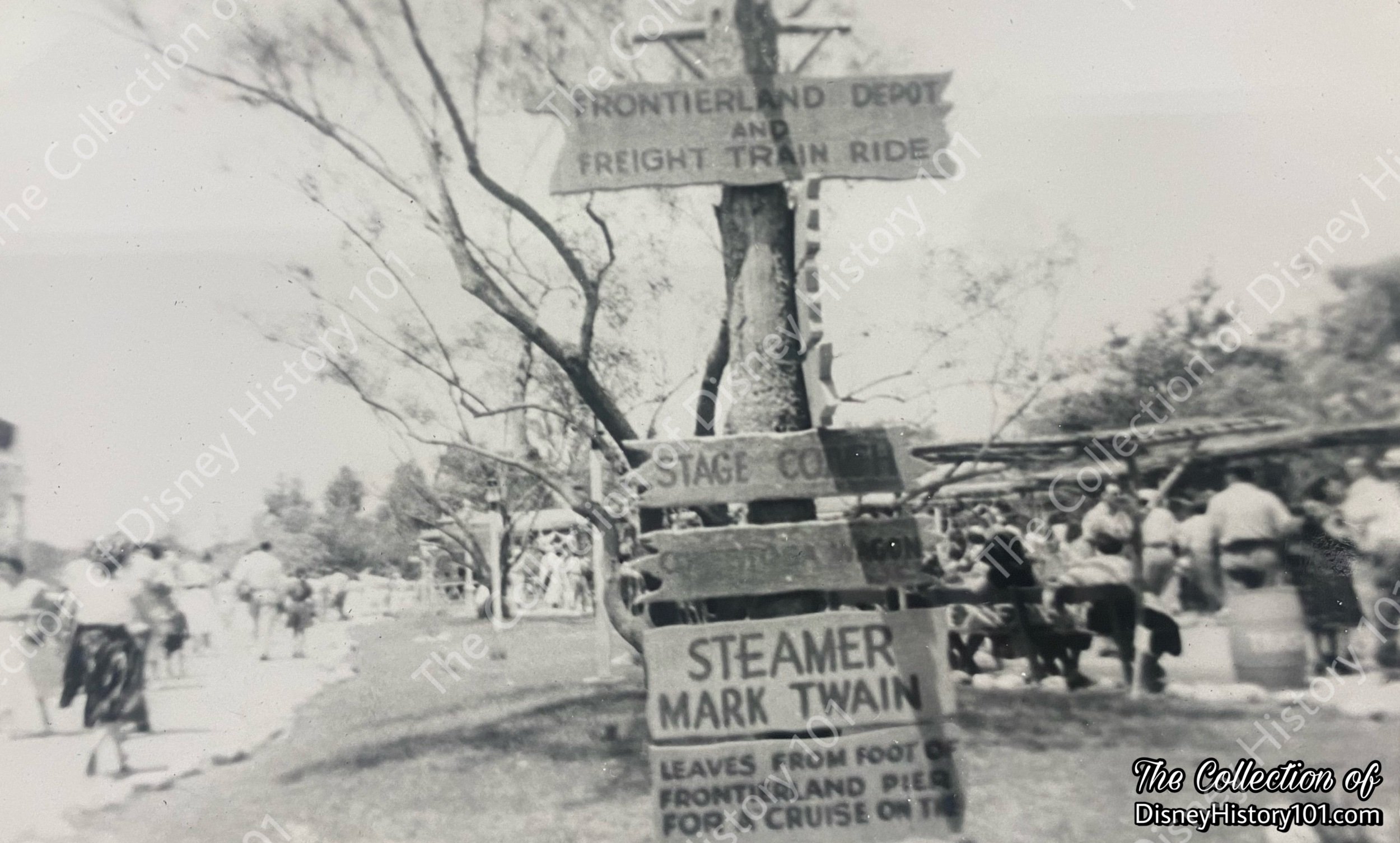
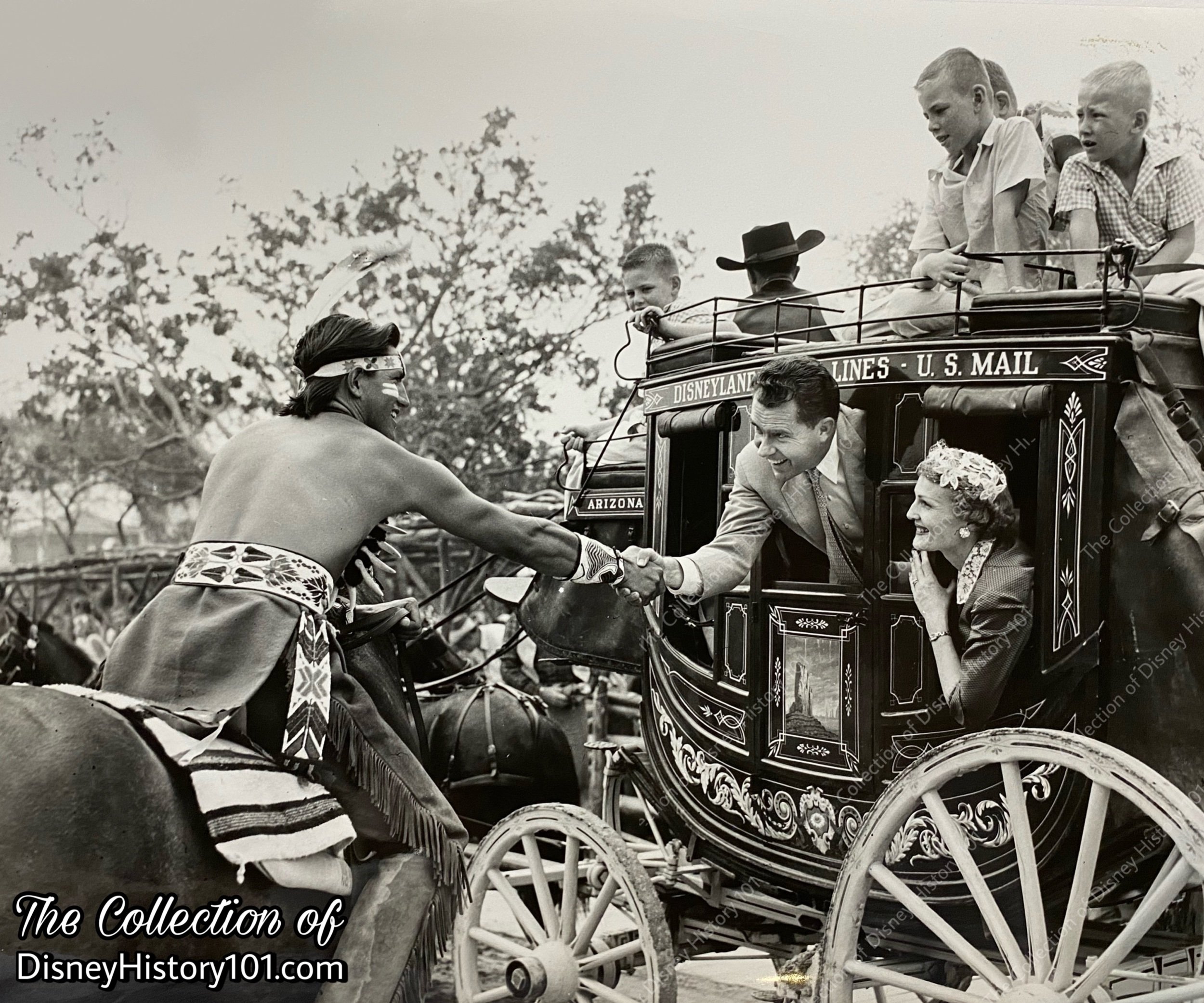
Once through the Frontierland Stockade, they headed off into (what Art Linkletter described as) “Stage Coach country.” Day Sechler recalled Danny Thomas and family riding aboard one of the Buckboards. Gale Storm and her kids rode inside on of the Stage Coaches.
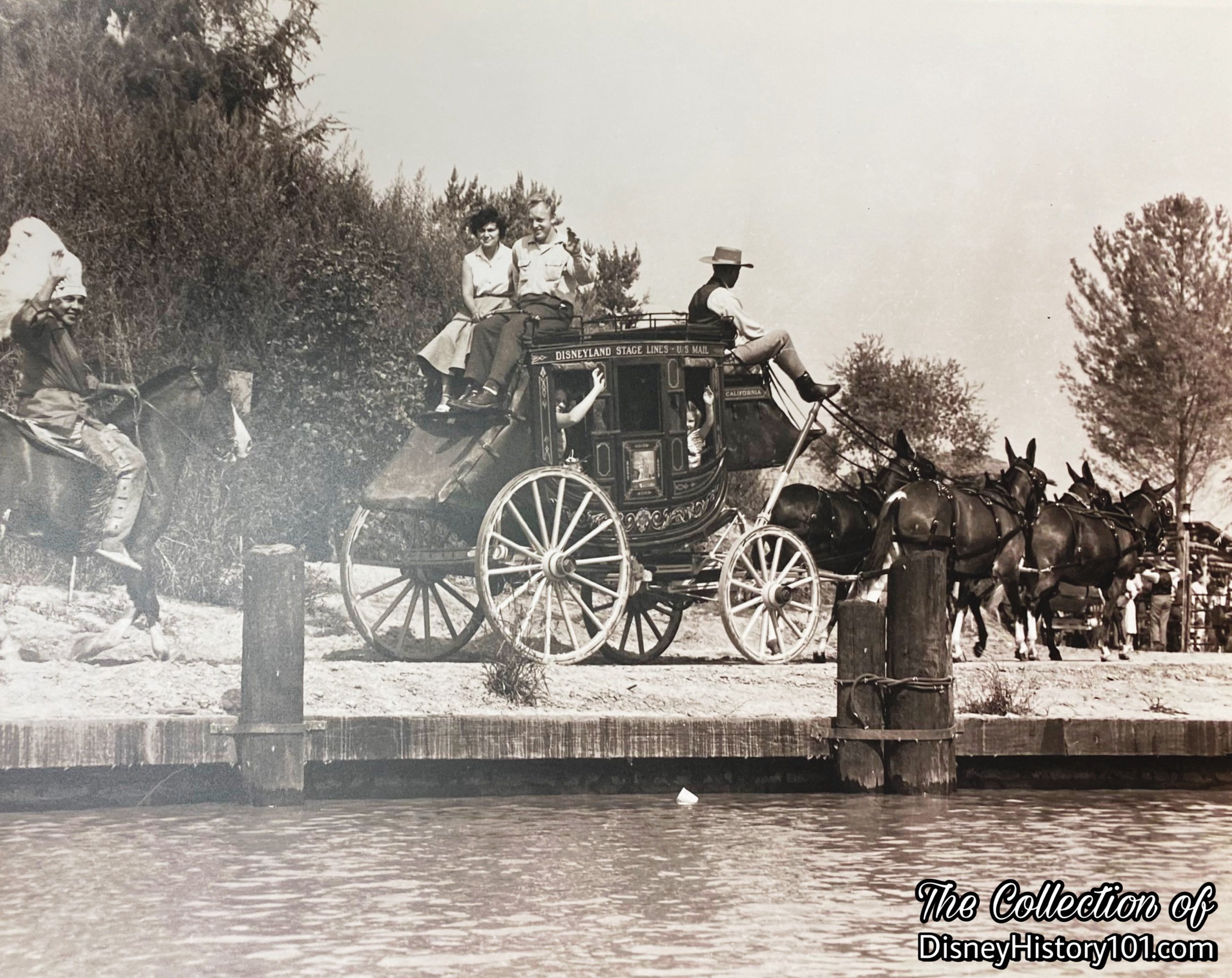
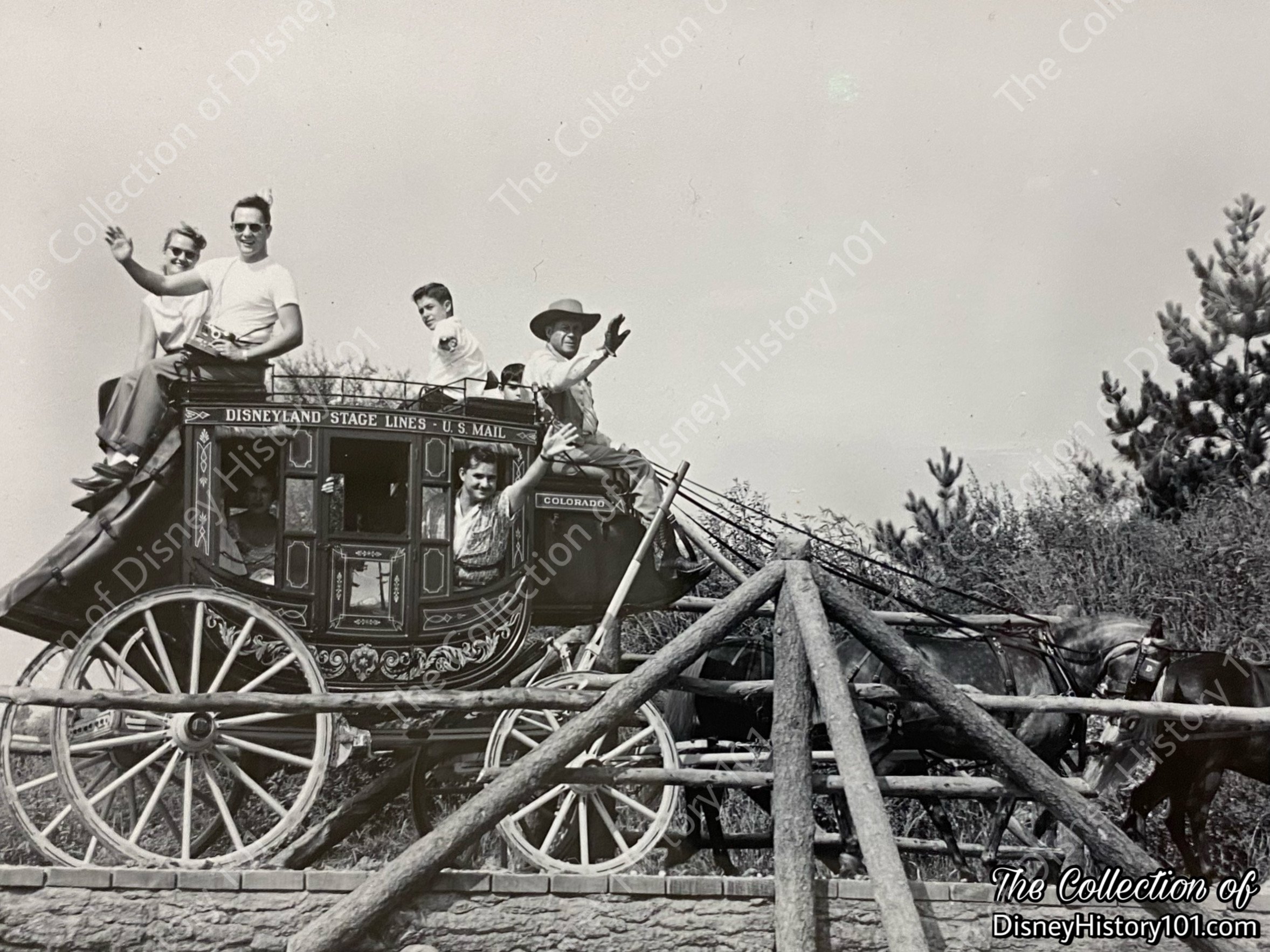

At long last, the Disneyland Stage Coaches (and their four-horse hitches) became 1 of 22 initial major attractions at Disneyland, on July 18th, 1955!

Your Guide To Disneyland, published 1955 featured a map of Disneyland depicting the Painted Desert and Wagon Trails stretched out over half of Frontierland (as drawn by artist Michael Harvey). The same map detailed where guests could experience a multitude of adventures by stepping aboard “Buggy Rides”, “Buckboard Rides”, “Wagon Rides”, “Stage Coach Rides”, and “Mule Pack Rides”! At the neighboring Blacksmith Shop, guests could “watch ponies being shod,” and “next door… the harness maker hard at work,” according to c. 1955 “Welcome to Disneyland” maps.
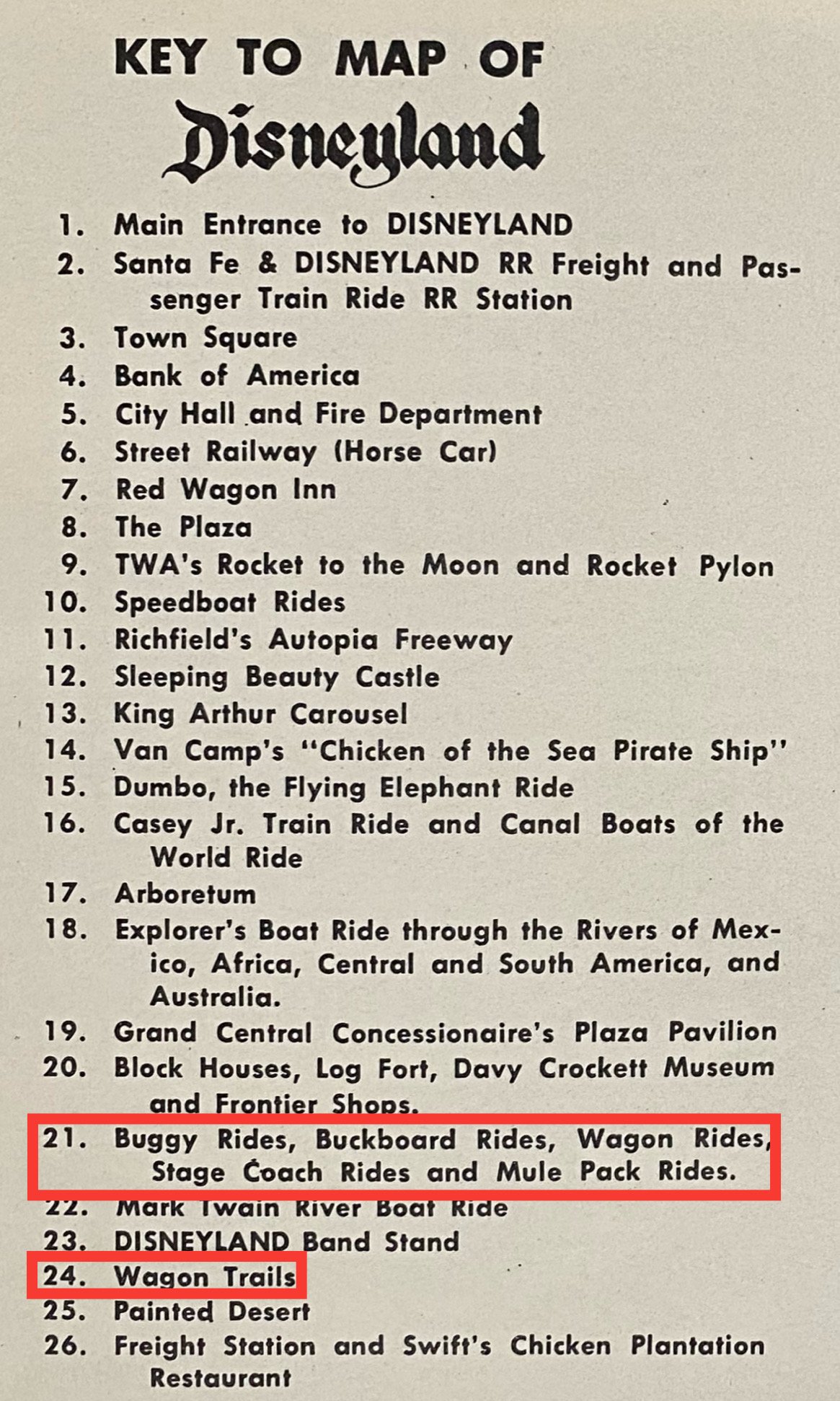
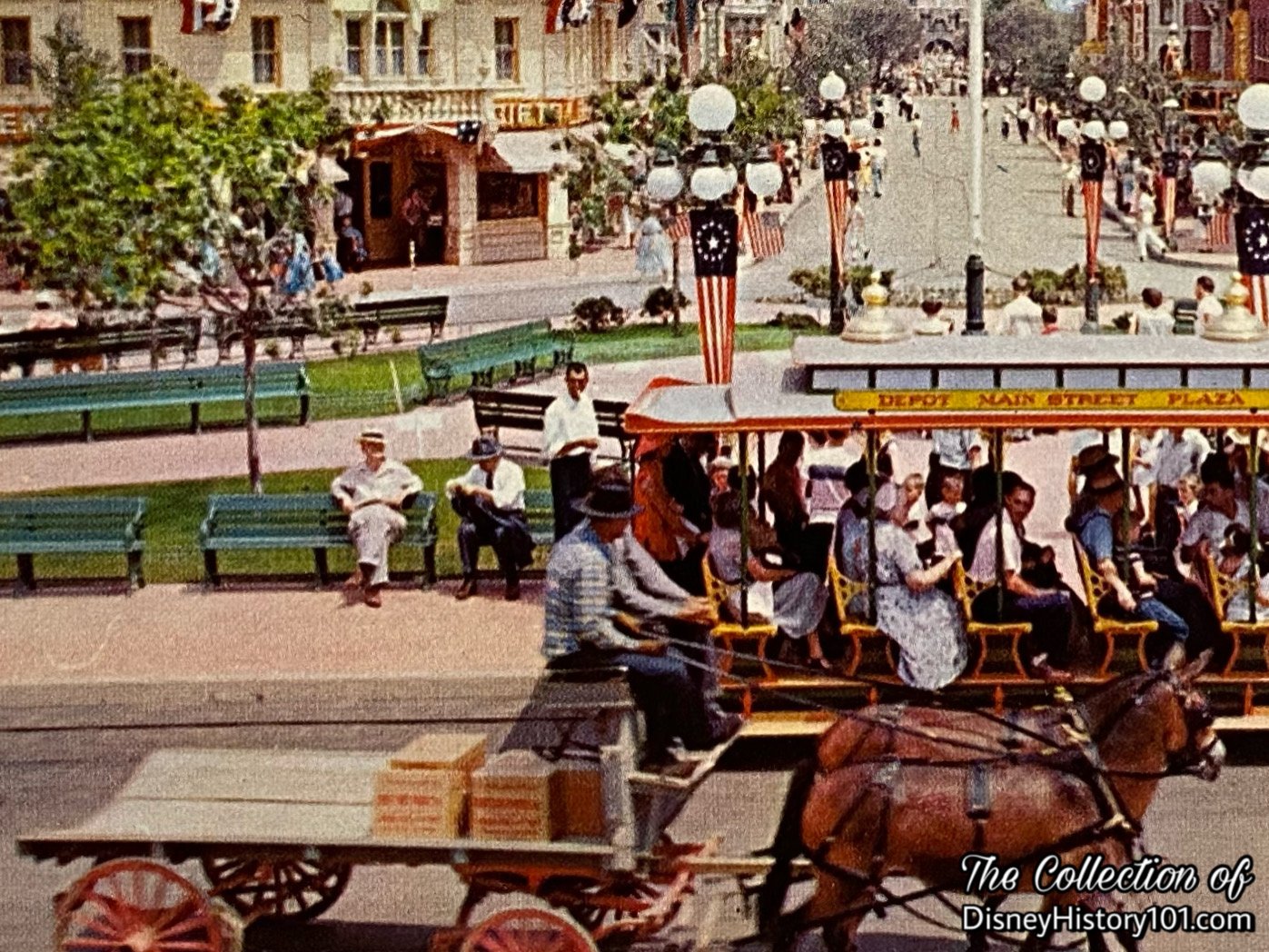
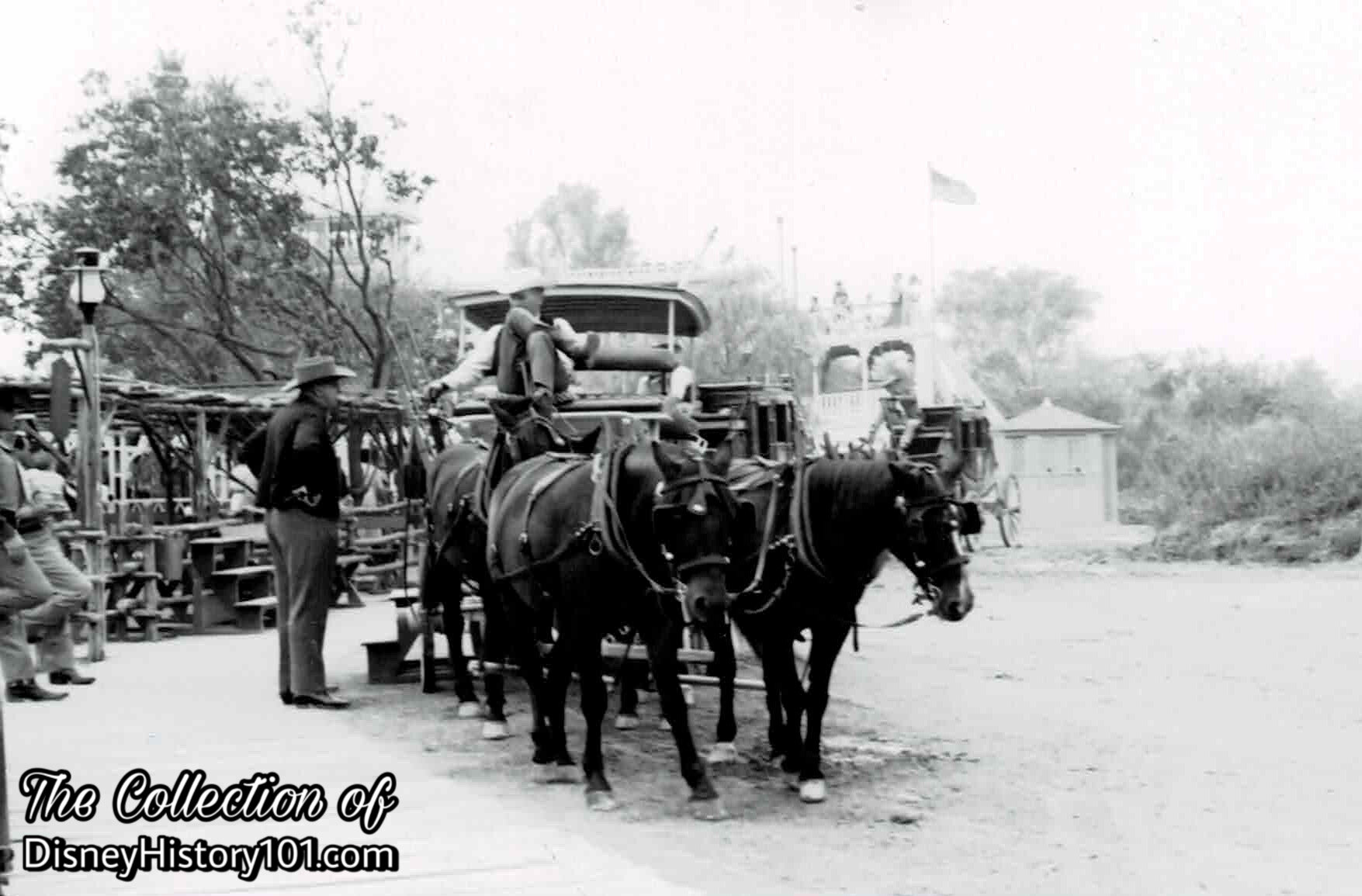
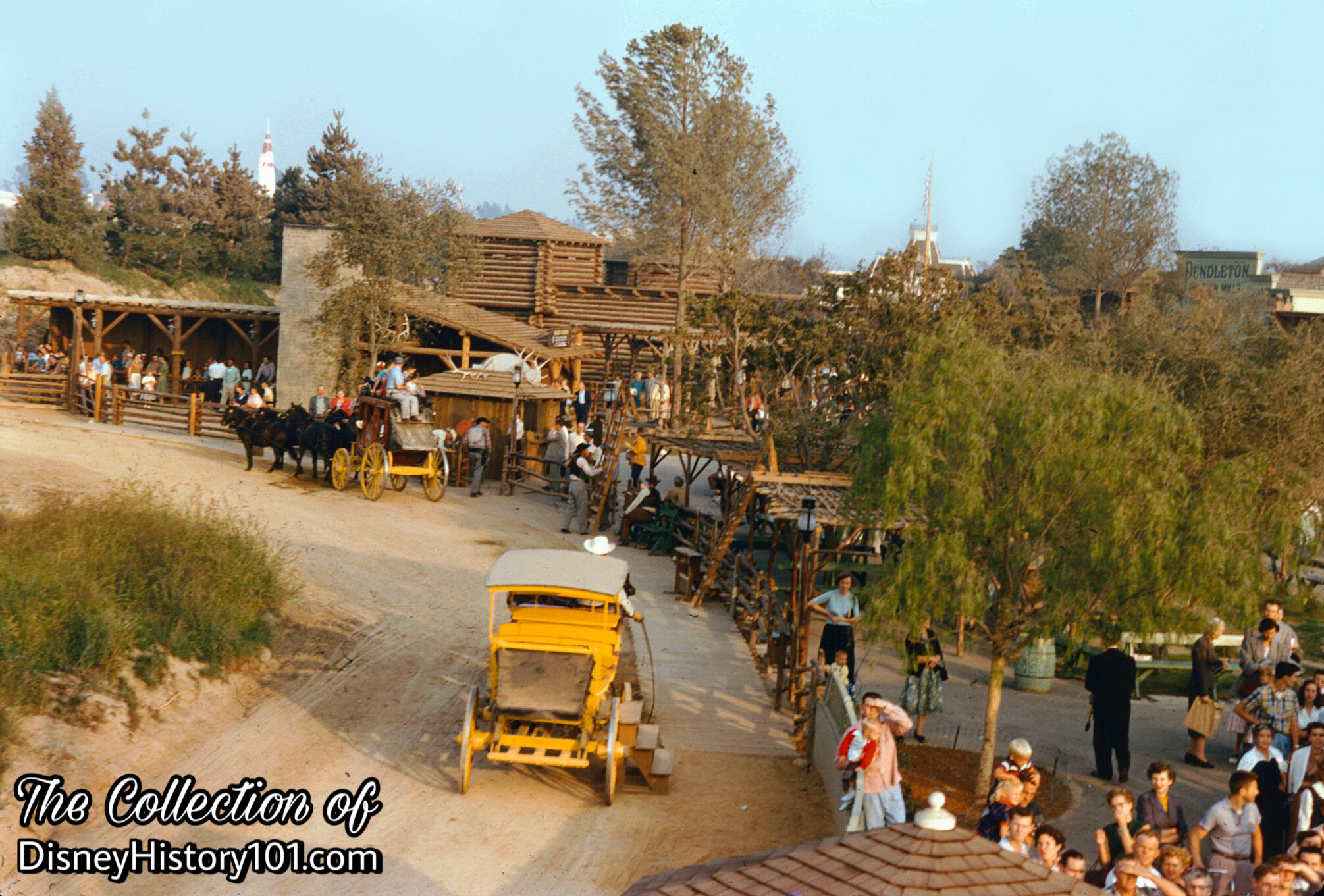
“Audience Waiting Areas” are especially designed as part of the attraction to make the guest's time waiting in line as comfortable as possible. The antler-crested structure (near the center) was the old Frontierland Depot, where passage was booked and tickets acquired aboard one of the Stage Coaches, Conestoga Wagons or Pack Mules. It was Just beyond the Frontierland Stockade, guests step aboard a Disneyland Stage Lines Stage Coach (and a Yellowstone Coach in the foreground) prepared to wheel across the desert and rugged wilderness, as their passengers relive the Frontier days of hardy western pioneers!

Younger guests loved sitting inside, above, and (especially) riding “shotgun” in the Driver’s Box of the Disneyland Stage Lines Stage Coach. You may recollect the loading and unloading process took a few minutes to complete. During one Spring of 1956 Disneyland photoshoot, actress Spring Byington (of “December Bride) and child actor Bobby Diamond (of “Fury”) were photographed aboard the “Colorado” Stage Coach (with the tree artwork on the door) for their 1956 “TV Radio Mirror” photoshoot at Disneyland!
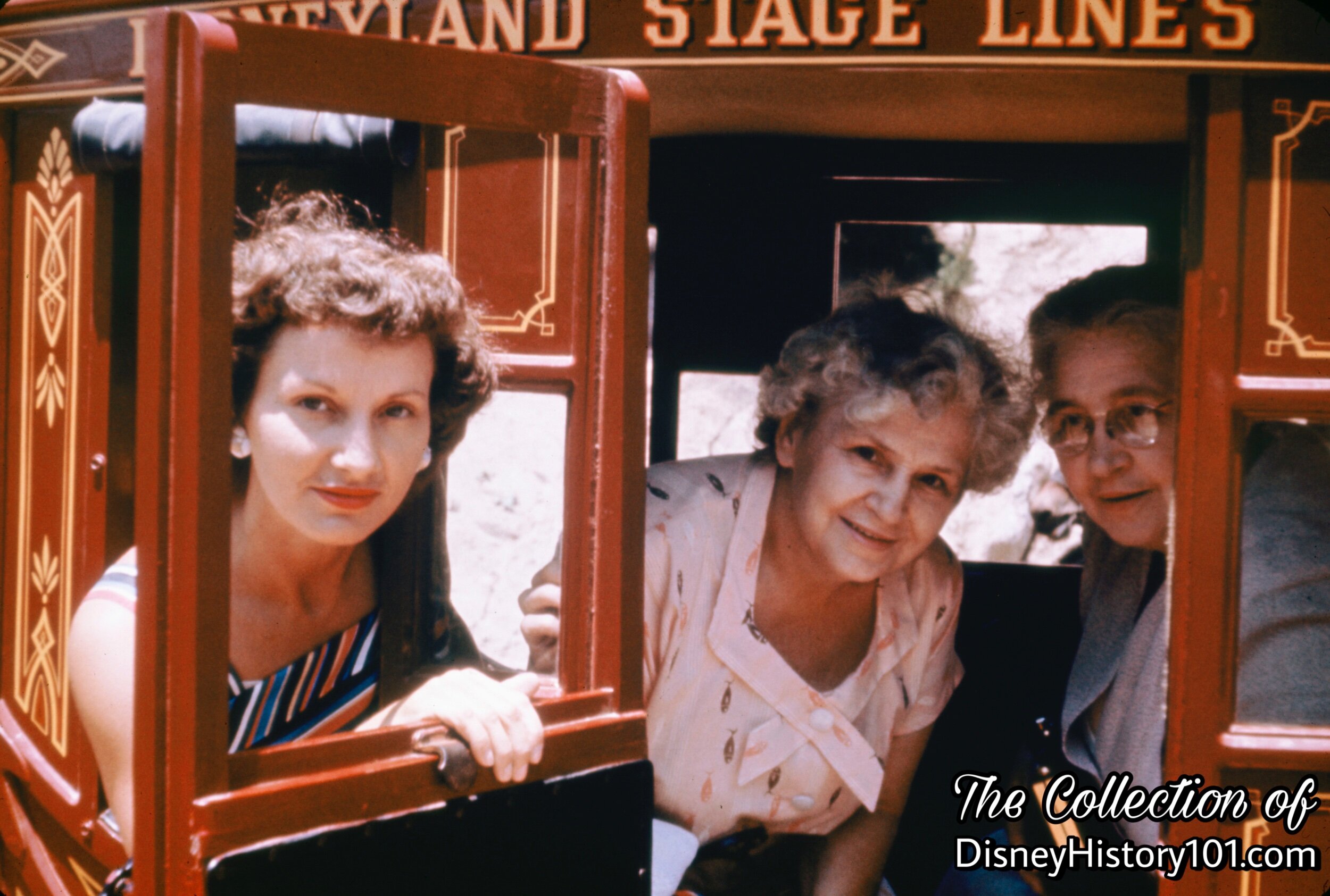
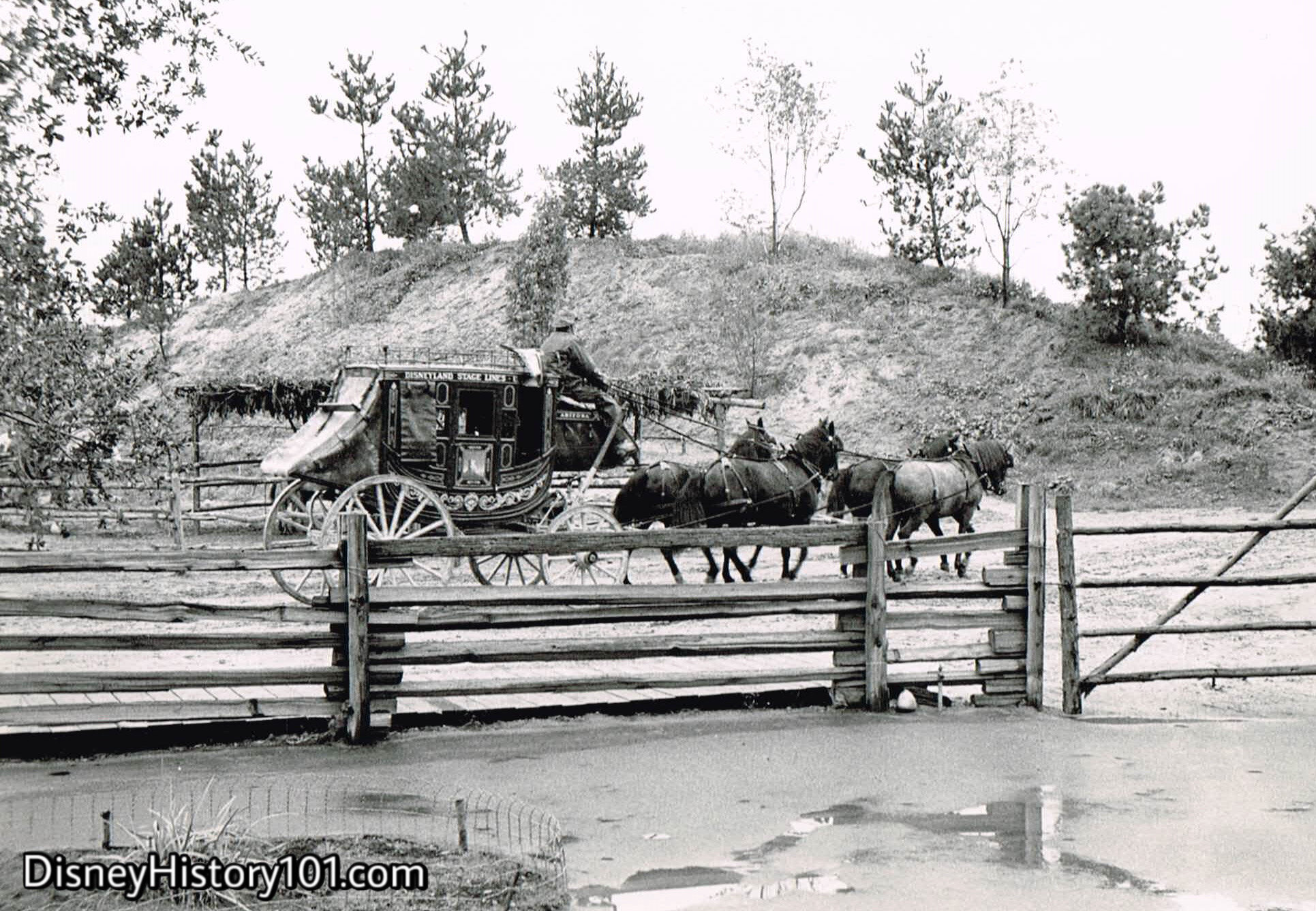
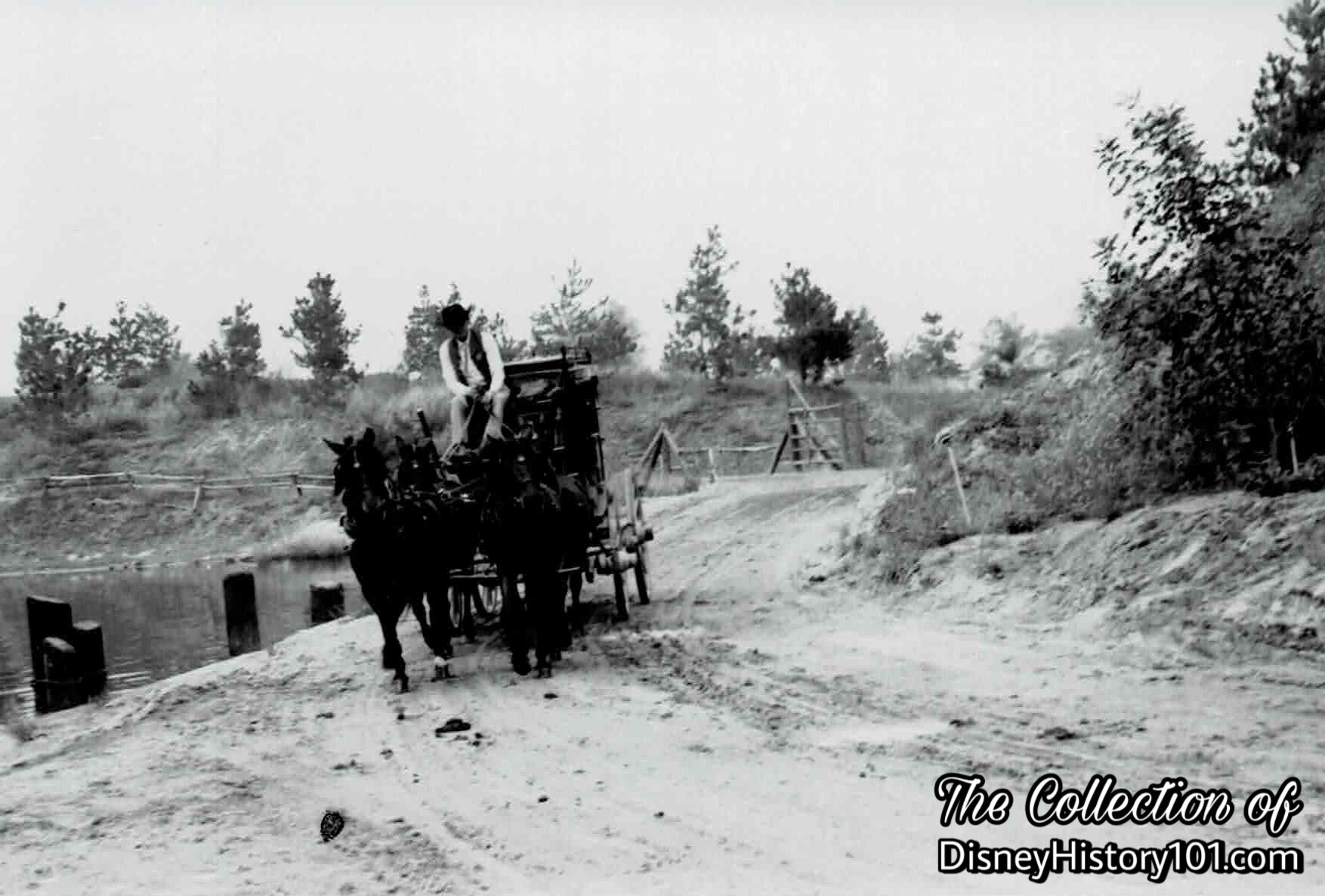
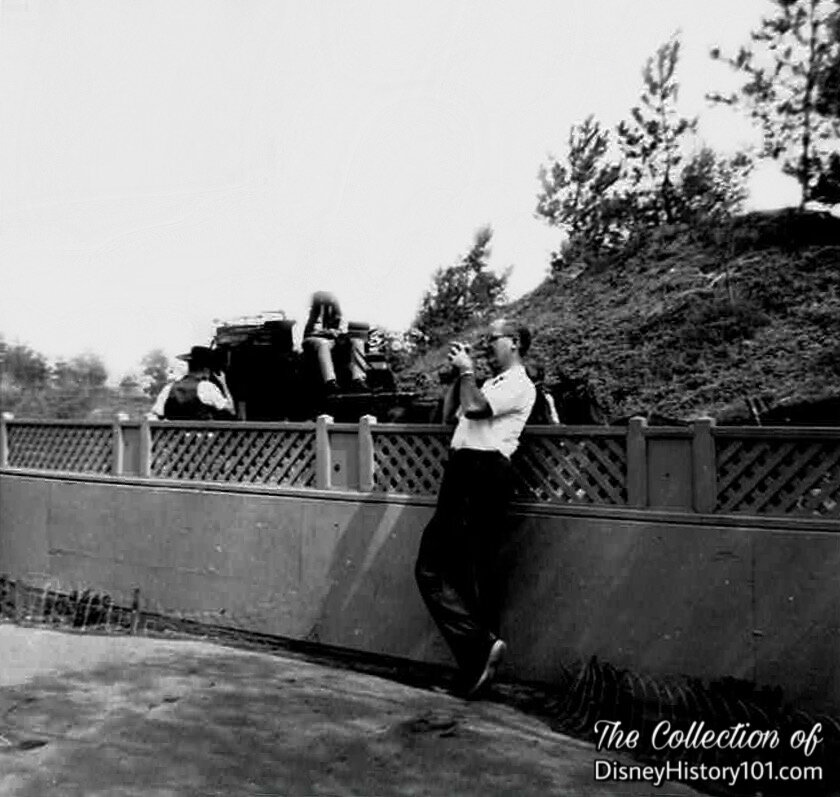
A Disneyland Stage Lines Stage Coach passes on the other side of the wall running from the Frontierland River “Boat Dock” to the Stage Coach Loading Platform and queue.
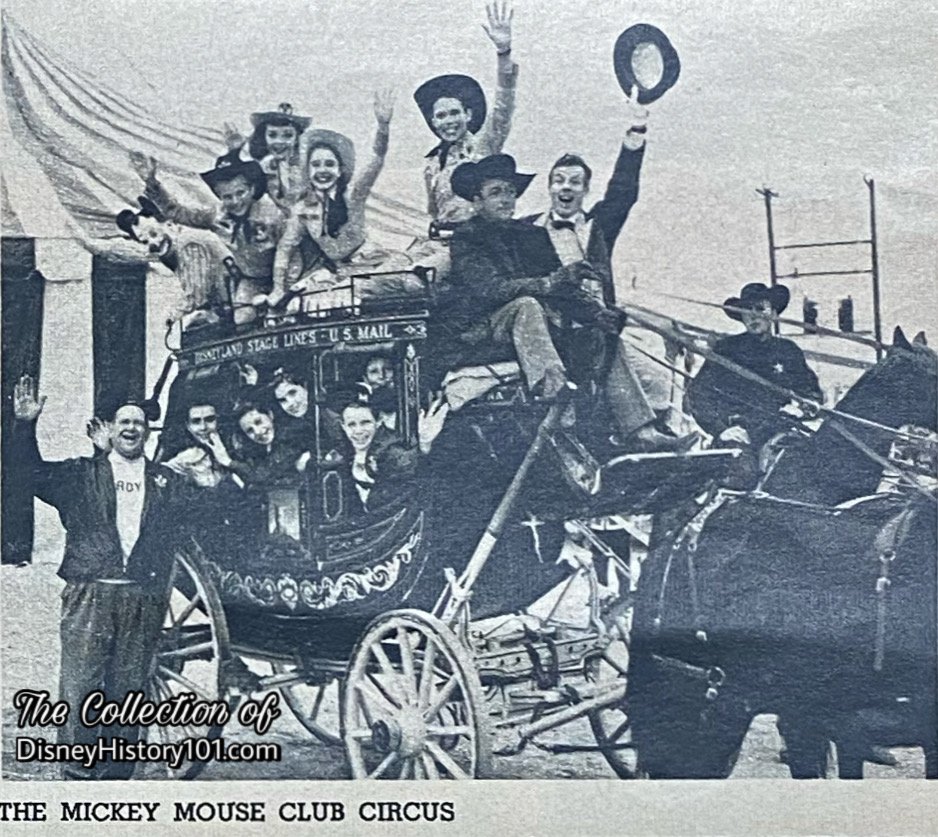
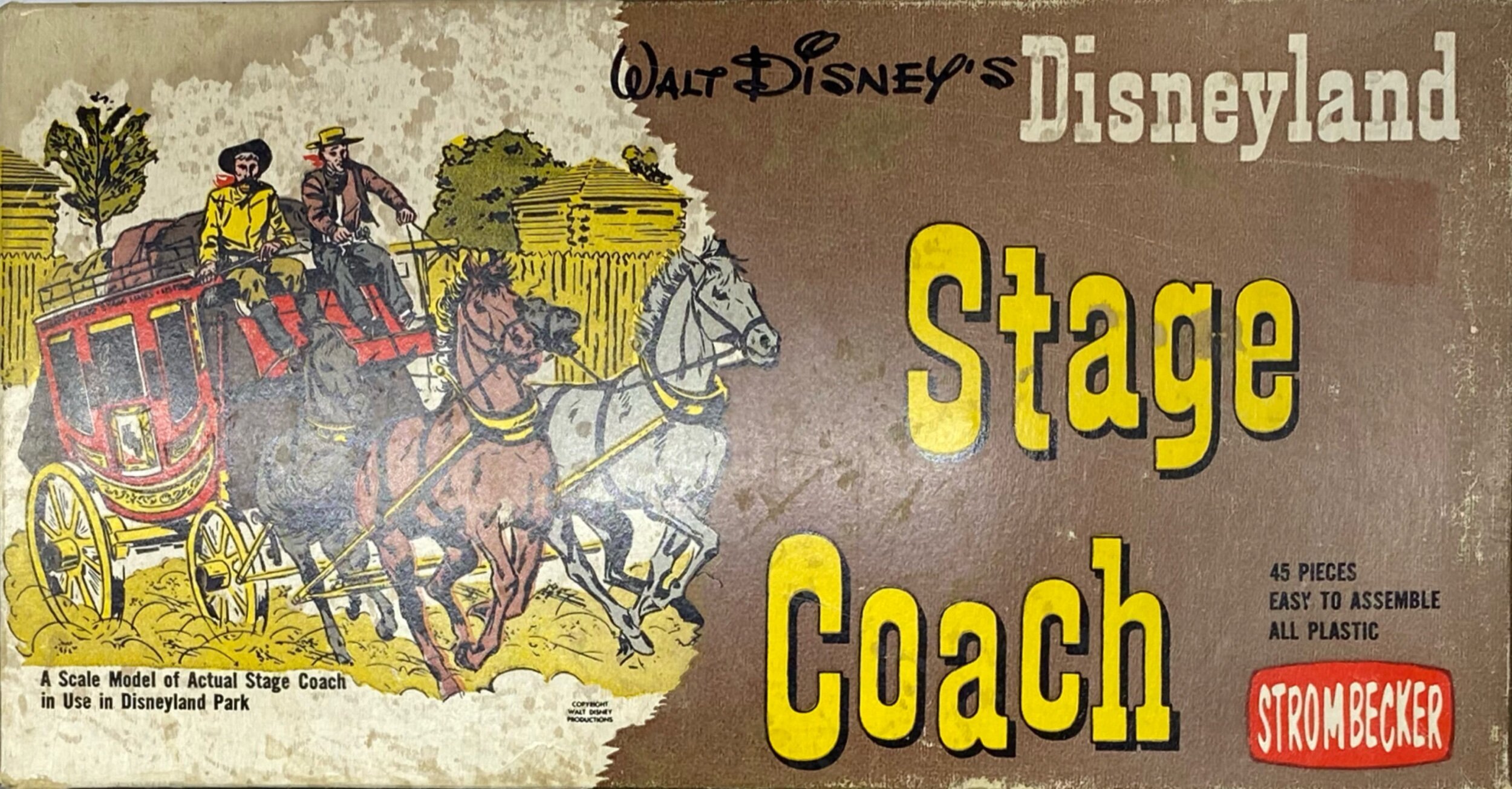
Disneyland provided an excellent outlet for licensed merchandising that was also available through retailers outside the park. Many of Disneyland’s iconic attractions were licensed as merchandise - from frame-tray puzzles and plastic toys, to salt-and-pepper shakers and ash trays. Some of them even received the “model” treatment - from the Global Van Lines Truck, to the “Jolly Roger” (known around these Disneyland parts as the Chicken of the Sea Pirate Ship Restaurant)! Strombecker manufactured several models of craft featured in Walt Disney’s “Man in Space” and “Mars and Beyond” (i.e. the Satellite Launcher, Moon Rocket, Space Station, and Space Ship), both Disneyland anthology series episodes of which first aired during 1955 and 1957. But now (by 1954-1955), Strombeck-Becker, Mfg. would commemorate the quaint and terrestrial Disneyland “Concord” Stage Coaches. By June 8, 1955, Mr. Lozier (of Walt Disney Productions Character Merchandise Division) had produced a model with horses, which had been approved by C.S. Olson (of Strombeck-Becker Mfg. Product Developement) and was ready to be presented to Philip Sammeth (of WDP Character Merchandise Division).
The final product was a Strombecker-manufactured easy-to-assemble 45-piece plastic Disneyland Stage Coach Model Kit, which was “a scale model of [an] actual stage coach in use in Disneyland Park” (as advertised on the box). The model kit came with decals to recreate the Disneyland Stage Lines Arizona Coach. This model was so popular (within 1954-55), that both Conestoga Wagon and Mule Pack kits (potentially Walt Disney Productions licensed merchandise) were also suggested by Strombeck-Becker Mfg.
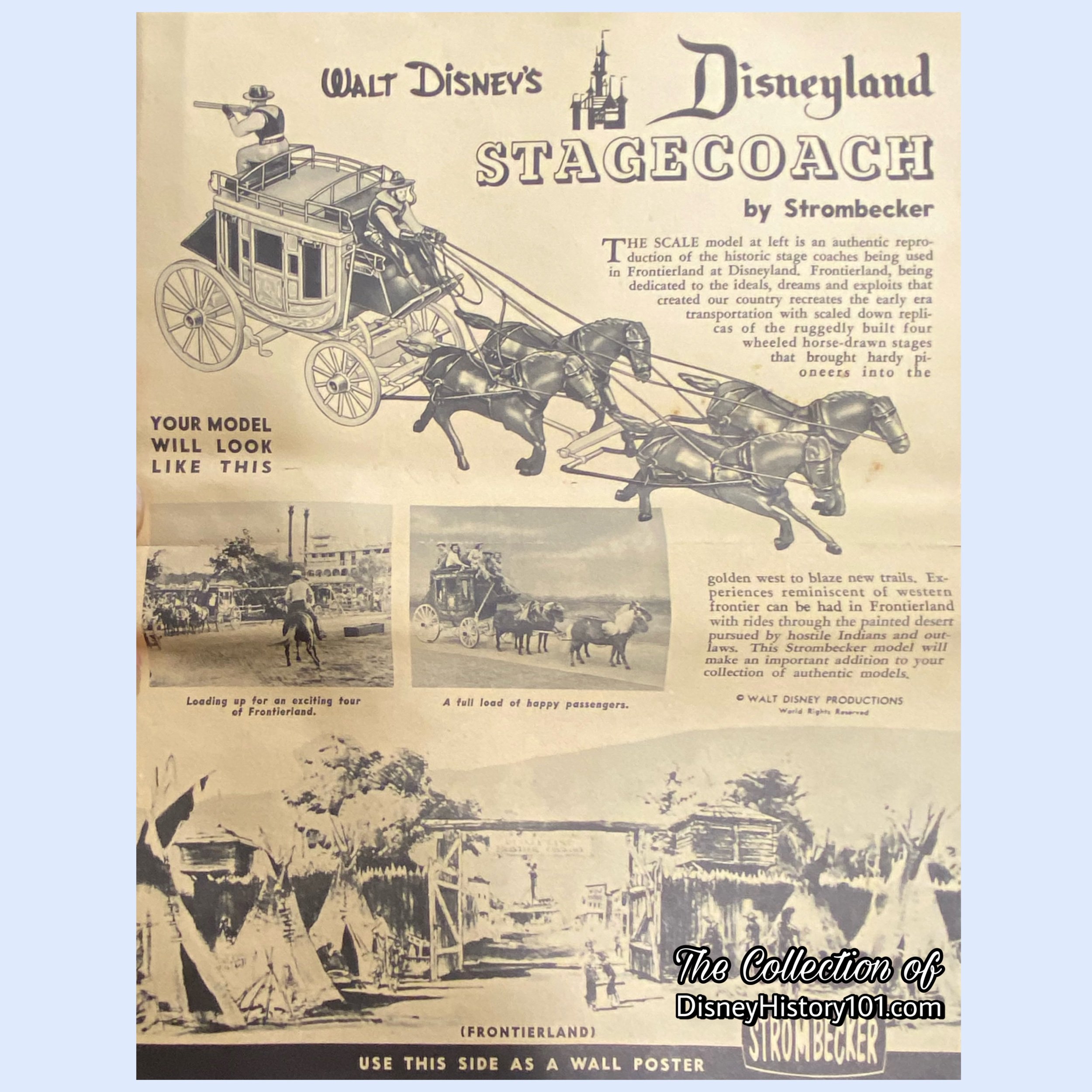
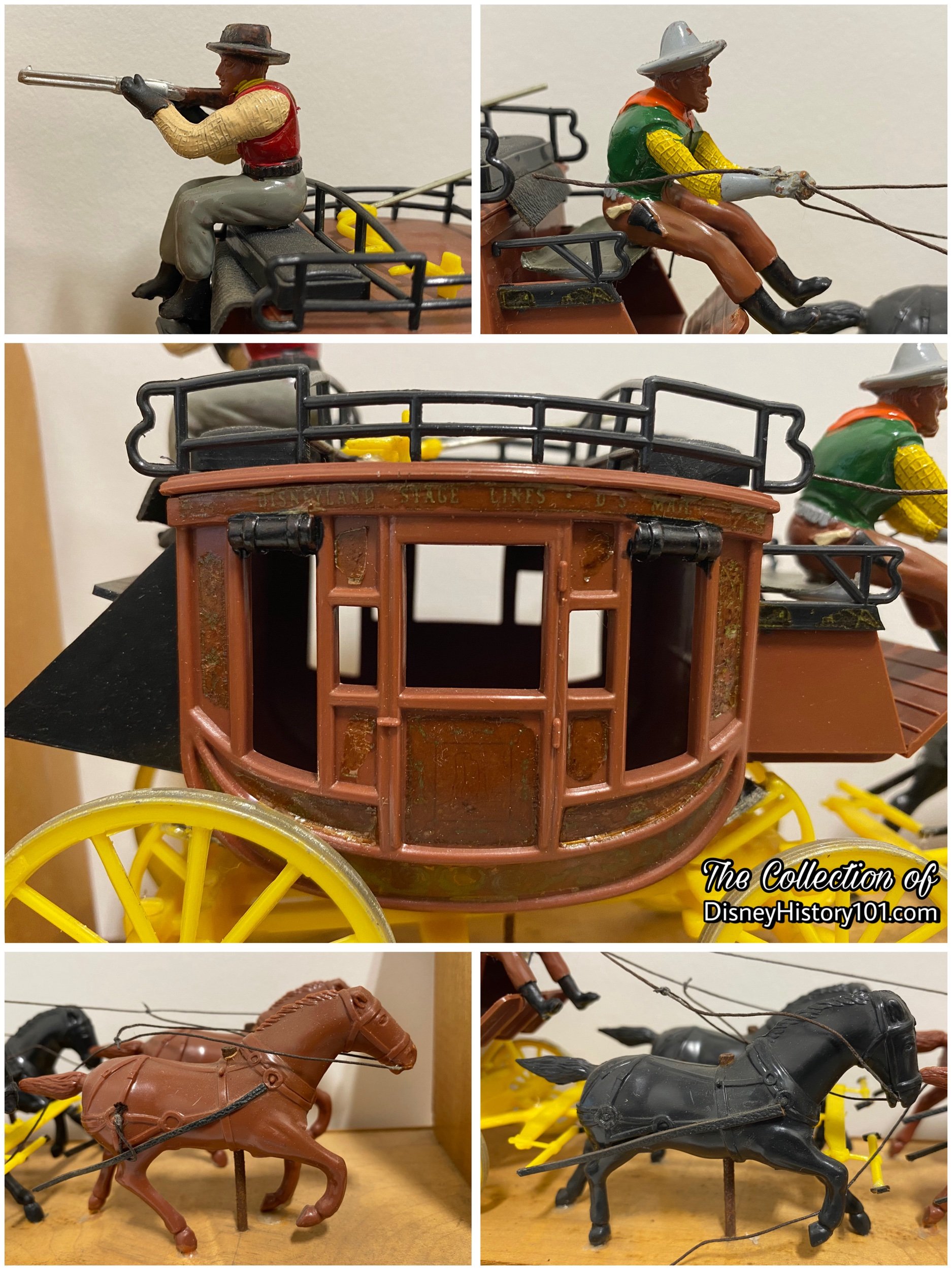
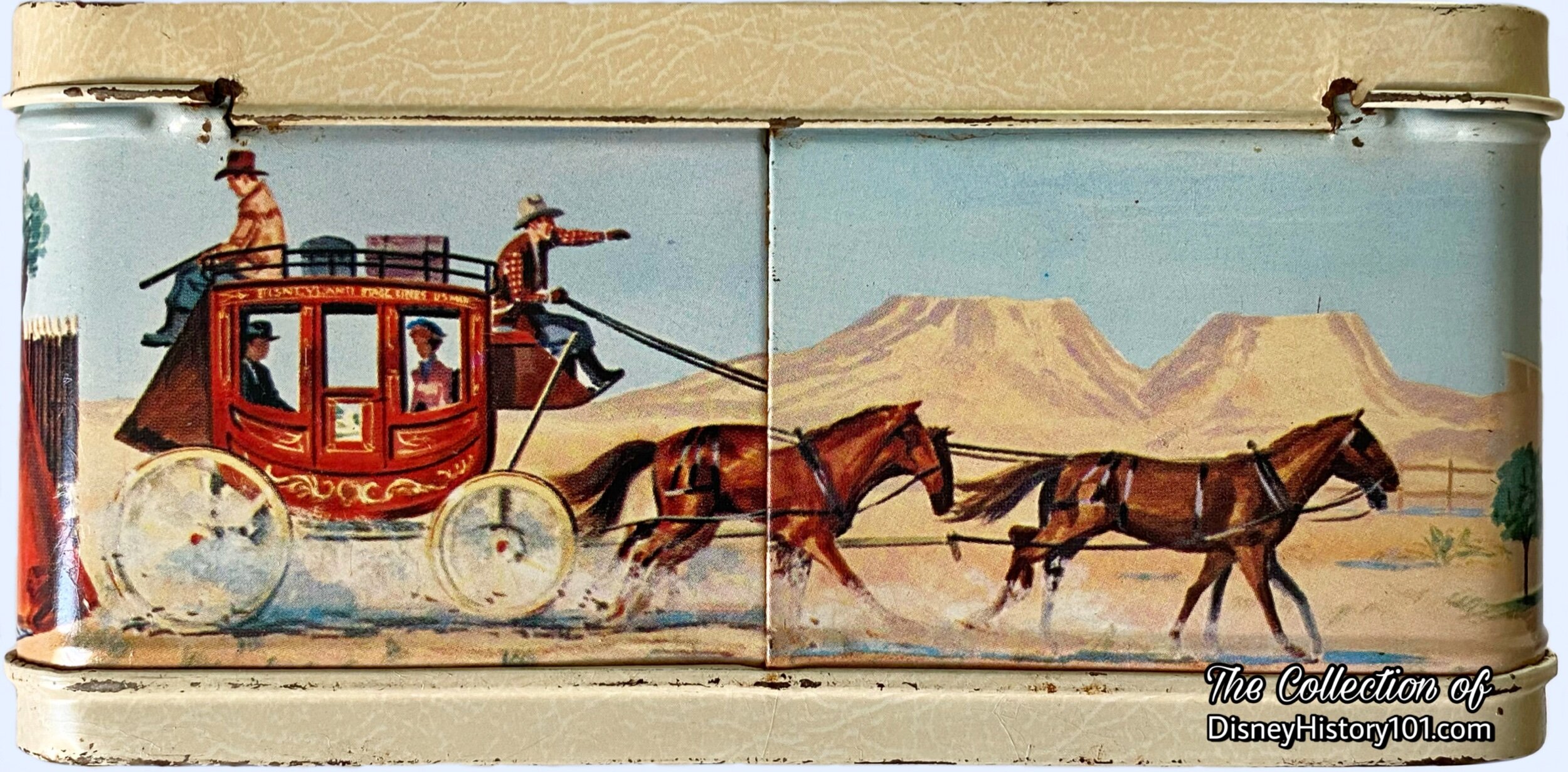
From iron-on transfers to lunch boxes - many other pieces of licensed Disneyland merchandise featured the character of the Rainbow Mountain Stage Coaches.


*Some sources as the Disneyland Rides, Attractions & Attendance Report cite February 10th, 1960 (though it is unlikely, as Nature’s Wonderland was under construction).
Times were “a changing’” and soon, new features of the desert were added to maps. At a meeting of the Disneyland Merchant's Association (held January 25, 1956), a momentous announcement was made: “All horsedrawn vehicles in the Frontierland area will be shutdown for approximately two months, during the redesign and reconstruction of this area. This will be a whole new development to increase ride capacity. We are building a mountain to be called Rainbow Mountain. This will be seen from the River and the Mark Twain. The existing corral and Black smith Show will be the entrance to a new ‘Mine Train’ ride. This will be an old fashioned Mining Train with 6 open cars. The engine will look like a real engine. The ride will go through a canyon out into the desert; then into a Rinbow Mountain where you tunnell with stalagmites and stalactities and three different water falls of different colors, joining in the river. This ride will take about 6 minutes…Stage Coach Rides route will be changed and we will add three new Stage Coaches.”
Other vehicles also started offering an alternate view of what was now billed as the “Rainbow Desert” (formerly the Painted Desert) beginning in 1956. The Disneyland Stage Lines Stage Coaches would embark from a cross-roads for all sorts of desert explorational vehicles - the new little mining town of Rainbow Ridge! Only now, the Disneyland Stage Lines Stage Coaches (also referred to as the “Yellowstone Stage Coaches”) would be renamed as the Rainbow Mountain Stagecoaches, and would soon be replaced by three Mud Wagons, or Buckboards - No. 4, No. 5, and No. 6 (intended to be pulled by a four-pony hitch). Once completed a 1958 appraisal placed the old western stage coaches and Conestoga wagons at a value of $172,800 (ride structure) and $36,790 (equipment).
This proved the truth of Walt Disney’s promise of an ever-expanding Disneyland! These new modes of desert transportation were among some of the exciting attractions debuting during 1956, that increased ride capacity! Owing to this, one day in August saw a peak total of “197,547 individual rides” enjoyed by Guests (according to a letter from Walt to Ward Kimball, dated January 23, 1957).
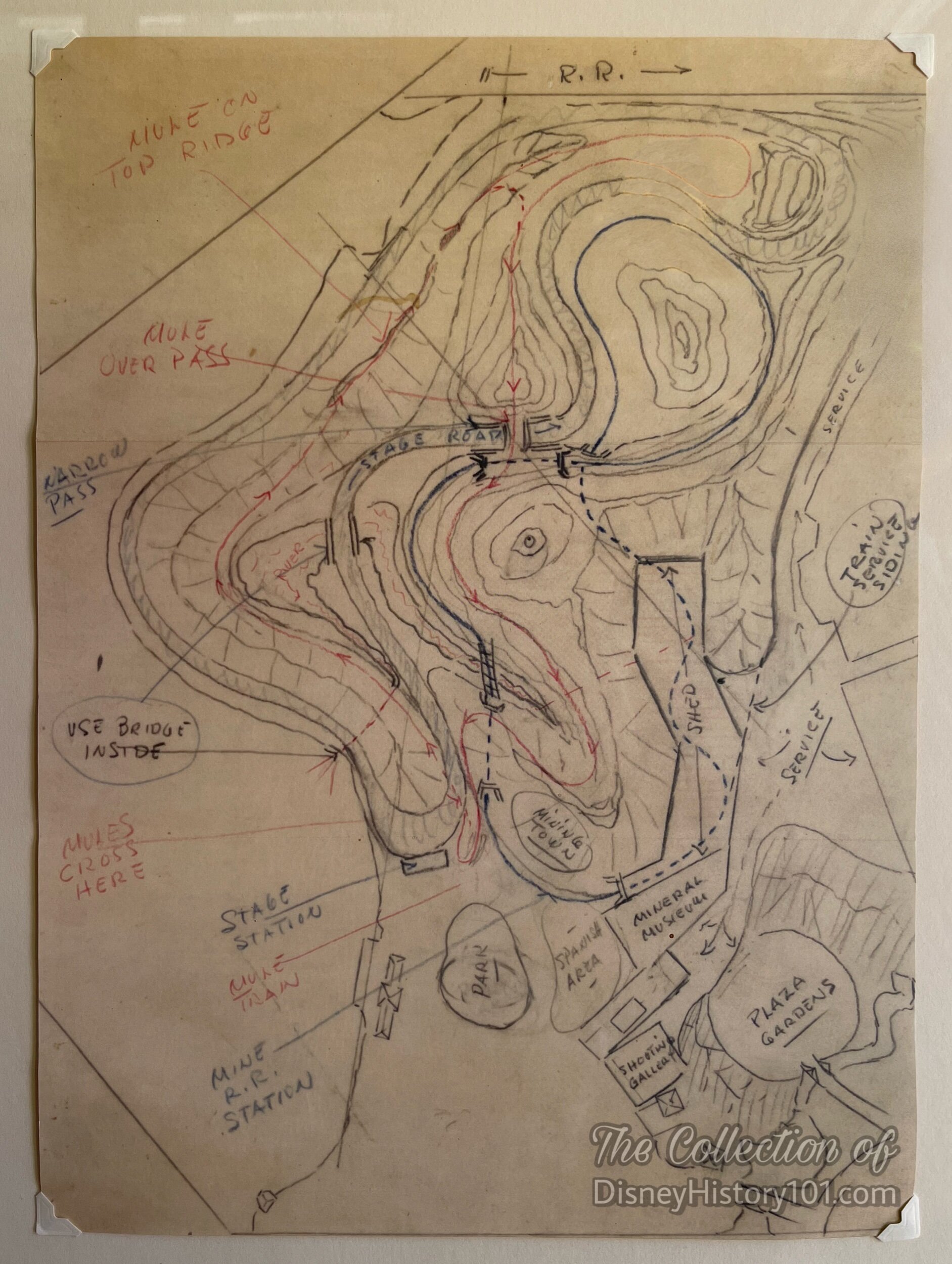
The region was initially called the ‘Painted Desert’ [in 1955]. It was redeveloped to add the Mine Train [July 2nd, 1956] and the name became the ‘Rainbow Desert.’ This was the name of the desert territory that the Disneyland Stage Lines Stage Coaches would traverse, for their duration of operation! These same Concord Stage Coaches (now renamed Rainbow Mountain Stage Coaches) would continue to give passage through the desert (from dawn until dusk) for three years.


In 1906 Frank had delivered fence posts to the Disney Farm in his Peter Schttler Wagon. When Walt and Roy came back for a visit in 1956 (not long after the addition of the Mud Wagons at Disneyland) they enjoyed a ride in the very same wagon pulled by mules.
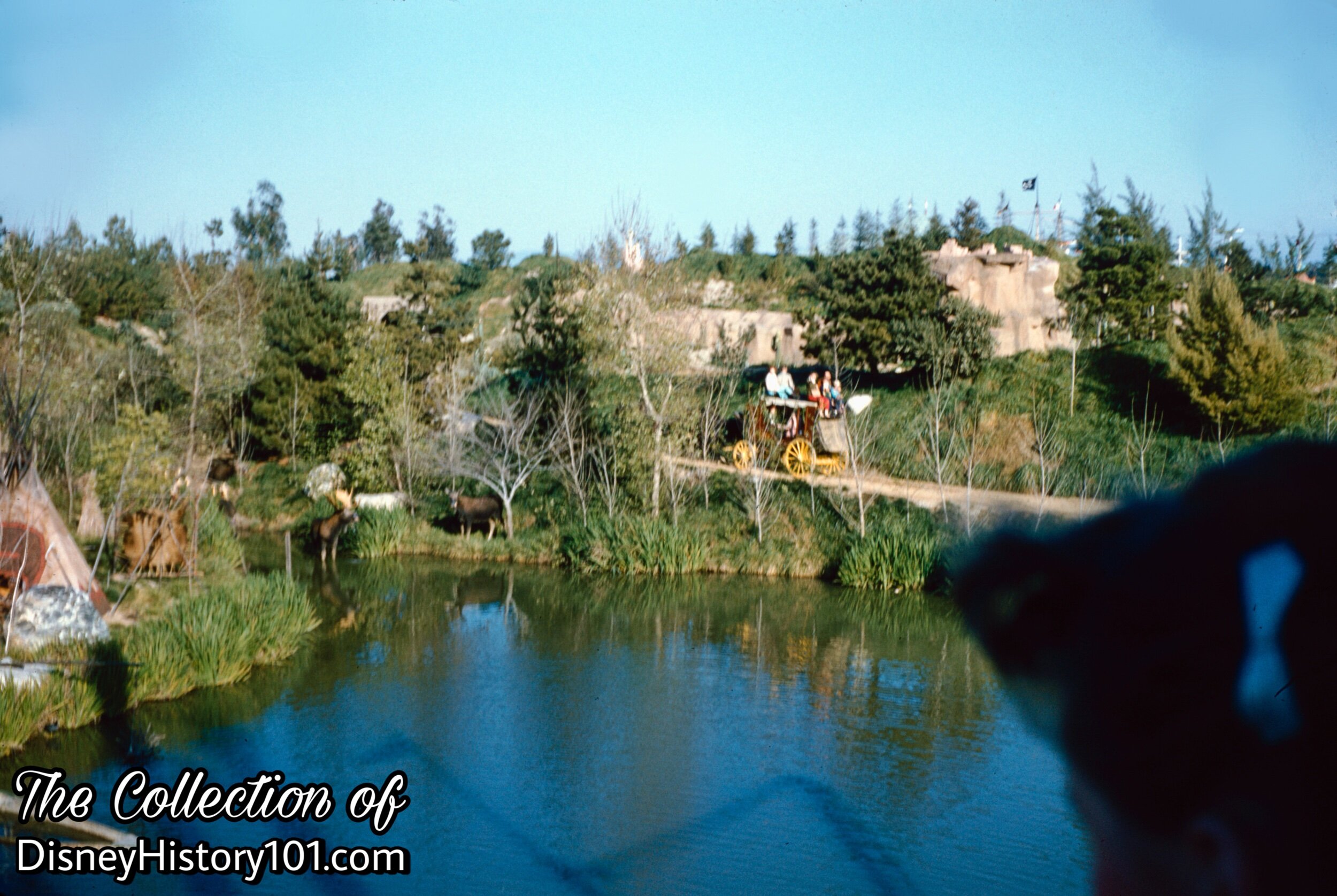
The Rainbow Mountain Stage Coaches continued through Friendly Indian territory, and once gaining passage, come to a fork in the road. Instead of heading over the berm (and toward the Pony Farm), the Stage Coaches head into the desert!
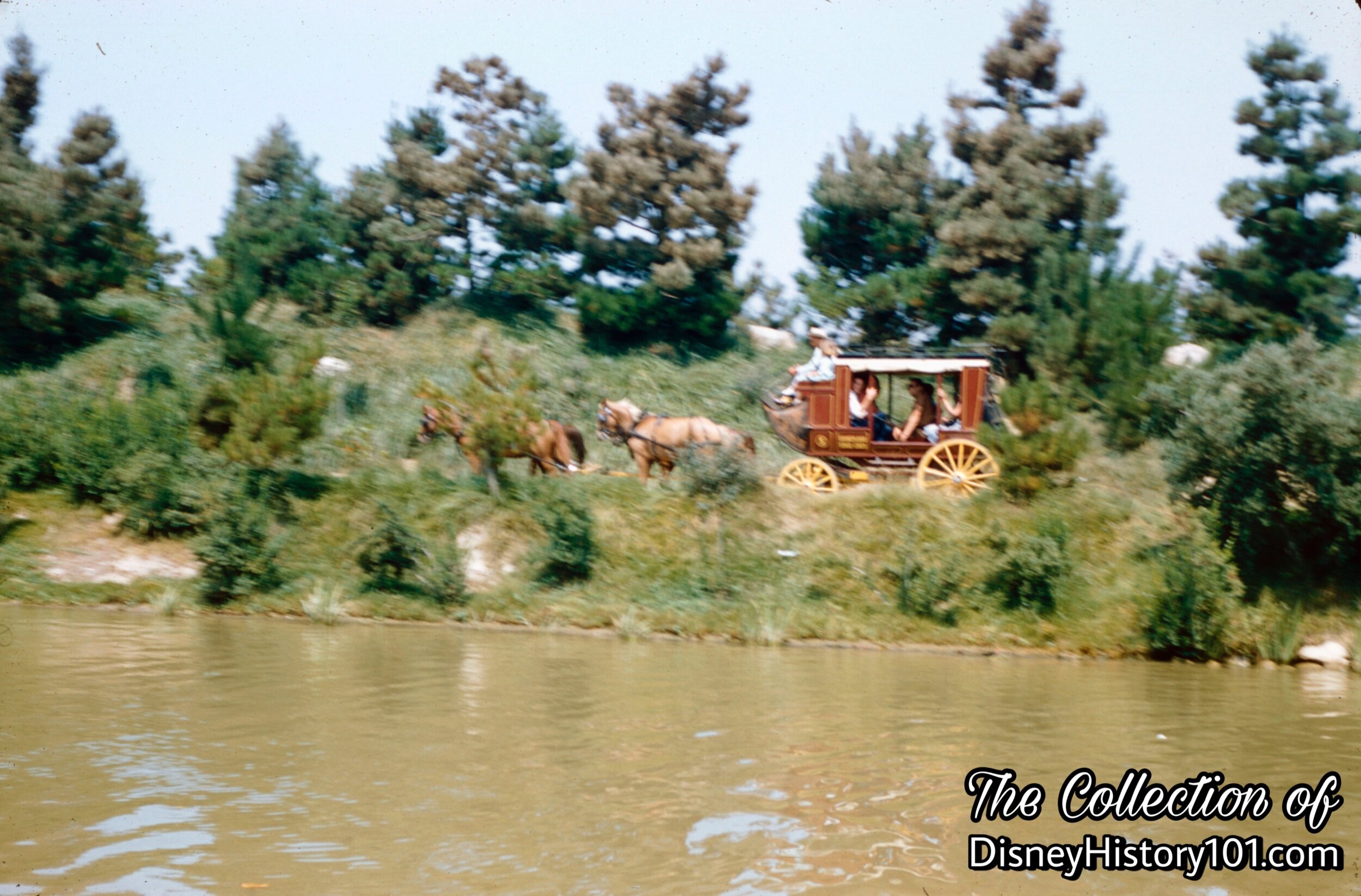
After departing the town of Rainbow Ridge, the Disneyland Stage Lines Stage Coaches ran along a route parallel with the waters of the Rivers of America!
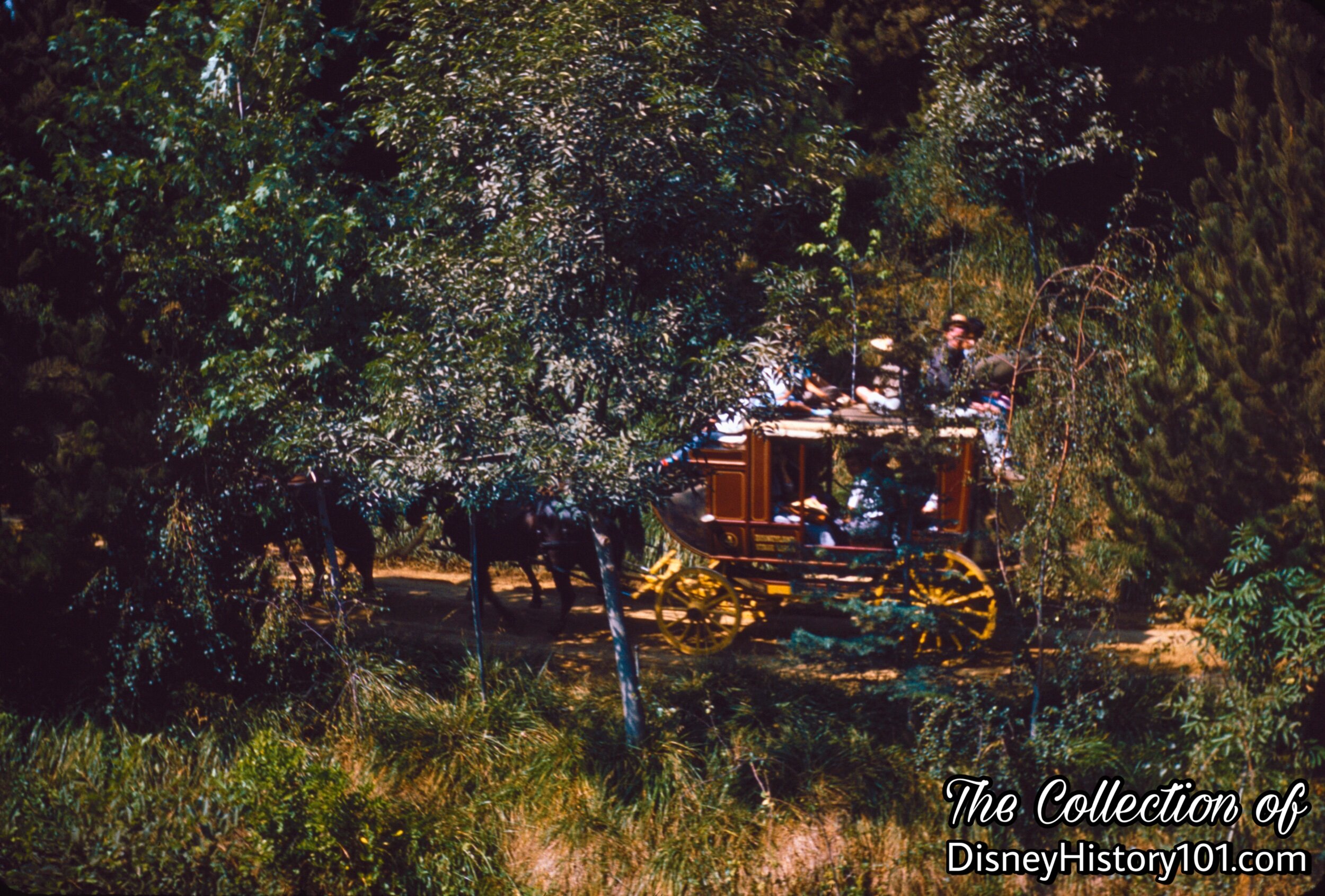

"The Official Guide to Disneyland" Excerpt, 1956. This is a Walt Disney Artist's conception of a section of FRONTIER-LAND in Disneyland, featuring the awe inspiring Mine Train Ride, the exciting Stagecoach and Mule Pack Rides, where one can journey through the many fantastic sights of the Rainbow Desert and Rainbow Mountain areas, returning with a view of the famous Mark Twain River Boat and Tom Sawyer Island.
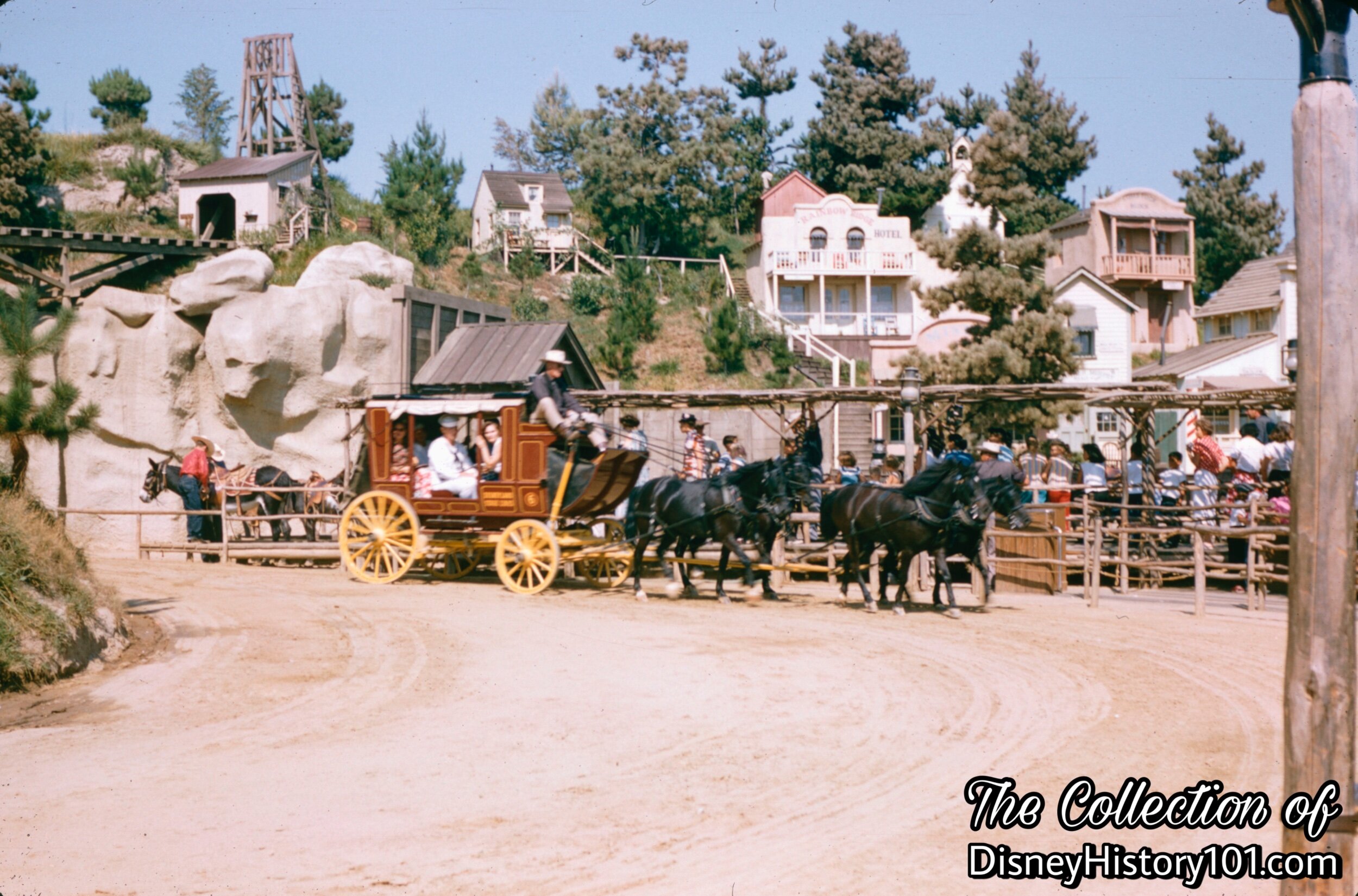
Rainbow Ridge would prove to be the crossroads for mine trains, pack mule trains, and the Disneyland Stage Lines Mud Wagon Coaches!
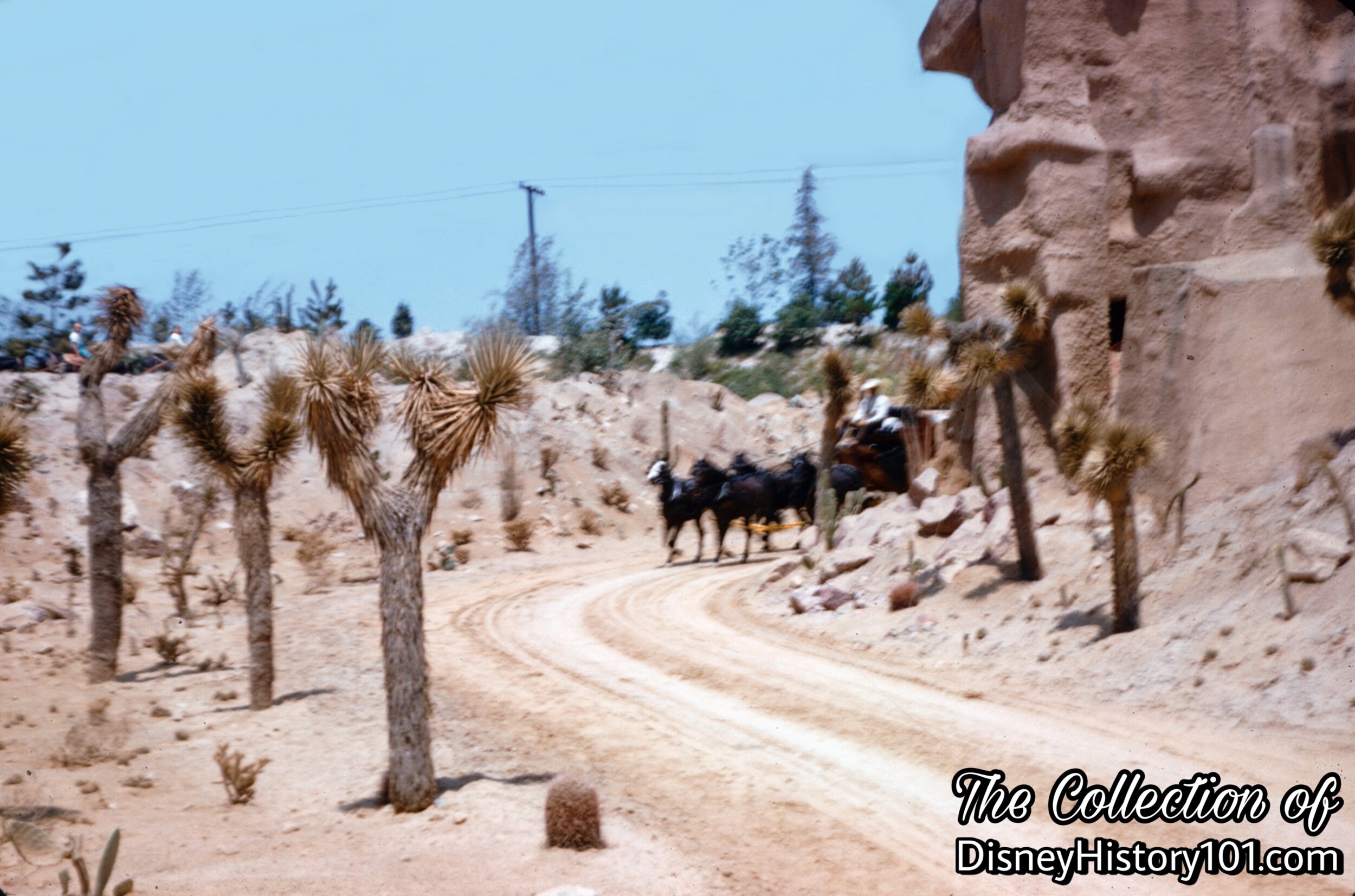
The Painted Desert was a true-life living desert of sand dunes and dry soil! Here Joshua Trees (pictured), Sahura trees, cactus, sagebrush, and other brightly colored flora line the dusty roads which the buckboard wagons and Conestoga wagons travel.
Disneyland was encircled by an earth wall called, the ”Berm.” Walt Disney's purpose was to make Disneyland a place separate from the world of today. It was intended that lush foliage screen out even more of the real world from sight. You may have noticed those telegraph lines at the horizon, behind that dirt berm in the background. Eventually those twentieth-century visual intrusions were removed from the sight of this On Stage area.
According to “Ripley’s Legends - pioneers of the Amusement Park Industry” by Tim O’Brien, Volume One: If the environment wasn’t believable, people wouldnt buy into the story. Martin Sklar recalled “one afternoon in Disneyland when he and a photographer drove a cat behind the scenes to Frontierland to take publicity photos. Walt saw what they were doing and was quite dismayed. ‘What are you doing with a car here in 1860?’ Walt queried as he was making a very strong point to both Marty and the photographer. Walt's point was that we had just destroyed the story. There was the Mark Twain (sternwheeler) with all these people aboard out in the wilderness and here we were with an automobile from another age. We had broken the continuity of the story. Visual intrusion is something we are constantly aware of today.”

Because the drivers of the Disneyland Stage Lines Stage Coaches, Buckboards, and Conestoga Wagons were wise to not travel through Balancing Rock Canyon, passengers received this preview of the hoodoos and arches that await them along a different desert route! Horses and mules are known to be spooked easily, sometimes by wildlife, like bounding Big Horn Sheep (but that’s another tale). It’s best that they keep their distance, because those toppling rocks overhead would (no doubt) have spooked the horses.

Admission for the Rainbow Mountain Stagecoach adventure during 1958, was one “jumbo” “D” coupon (the price of 35 cents, for one child), the same as the Jungle Cruise, Indian War Canoes, or the Tom Sawyer Island Rafts.
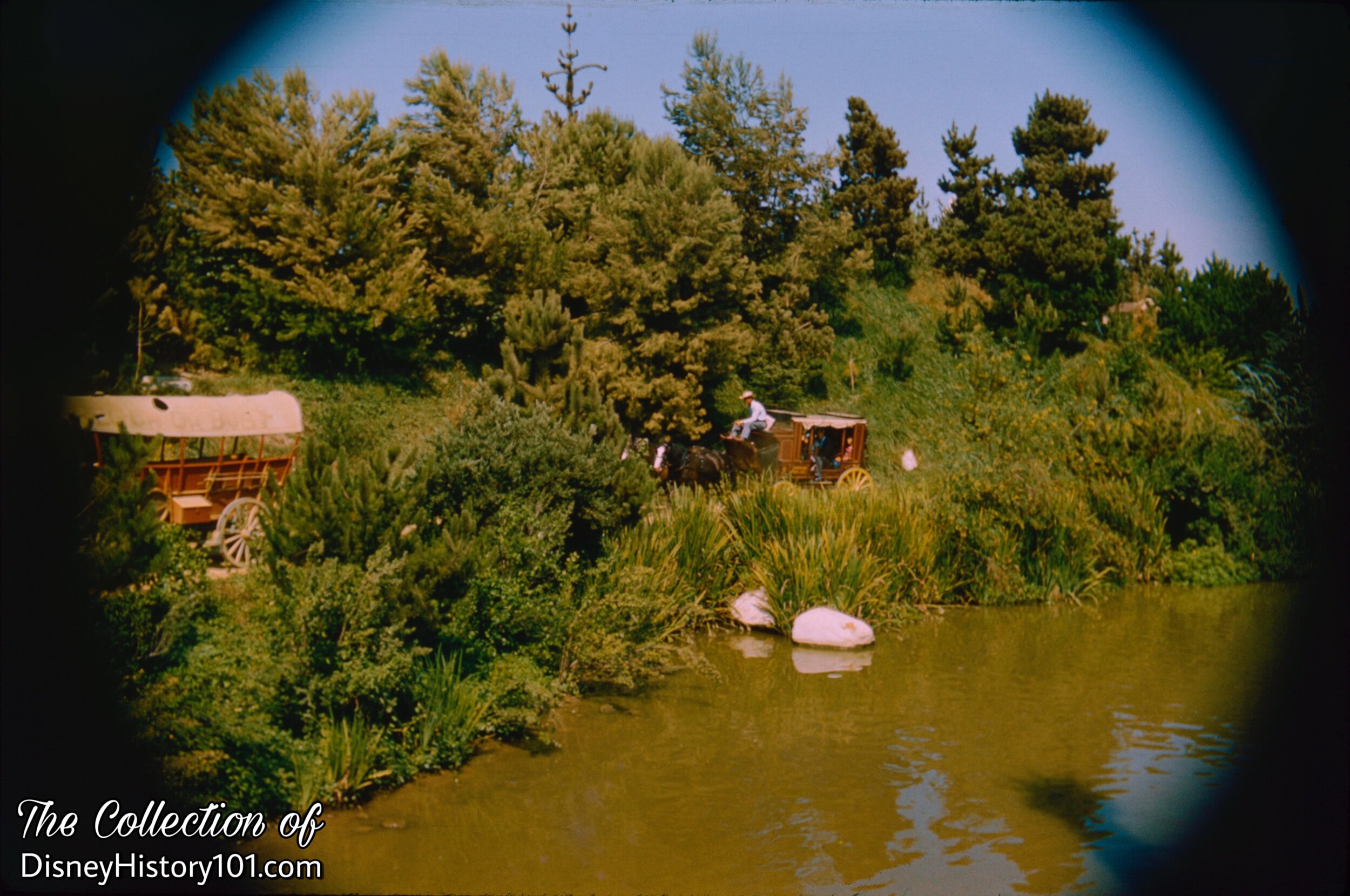
From Fort Wilderness and Tom and Huck’s Treehouse, we can see the Rainbow Mountain Mud Wagon Coach and another type of vehicle - Covered Conestoga Wagons - that blaze the trails of the Rainbow Desert on the other side of the Rivers of America!

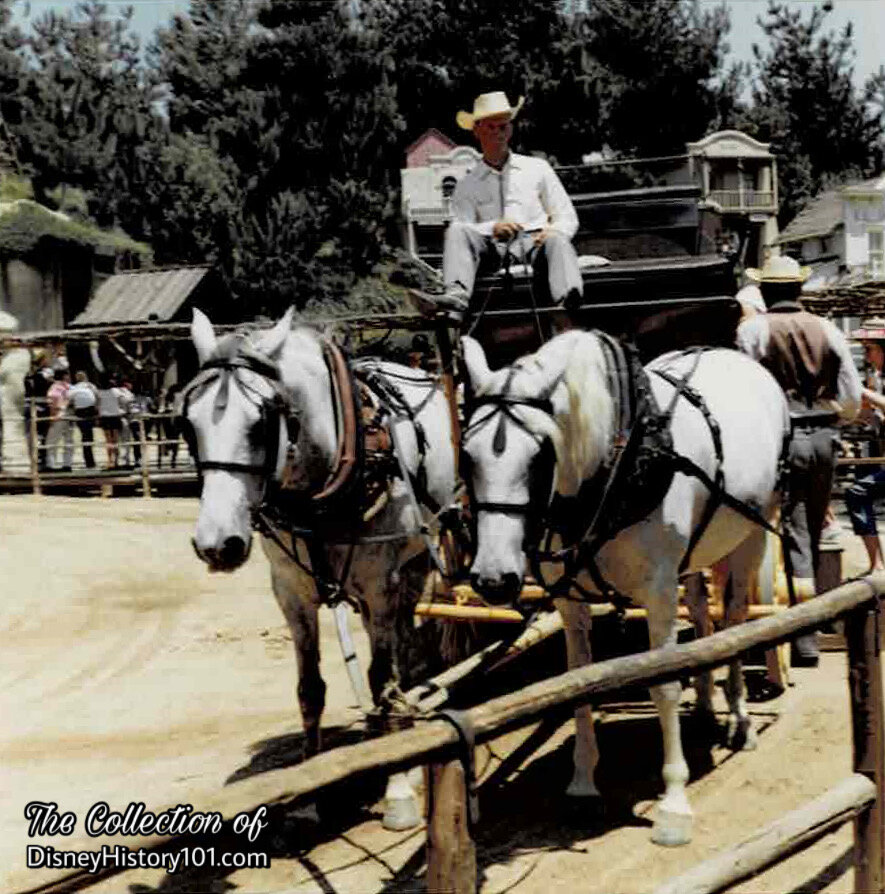
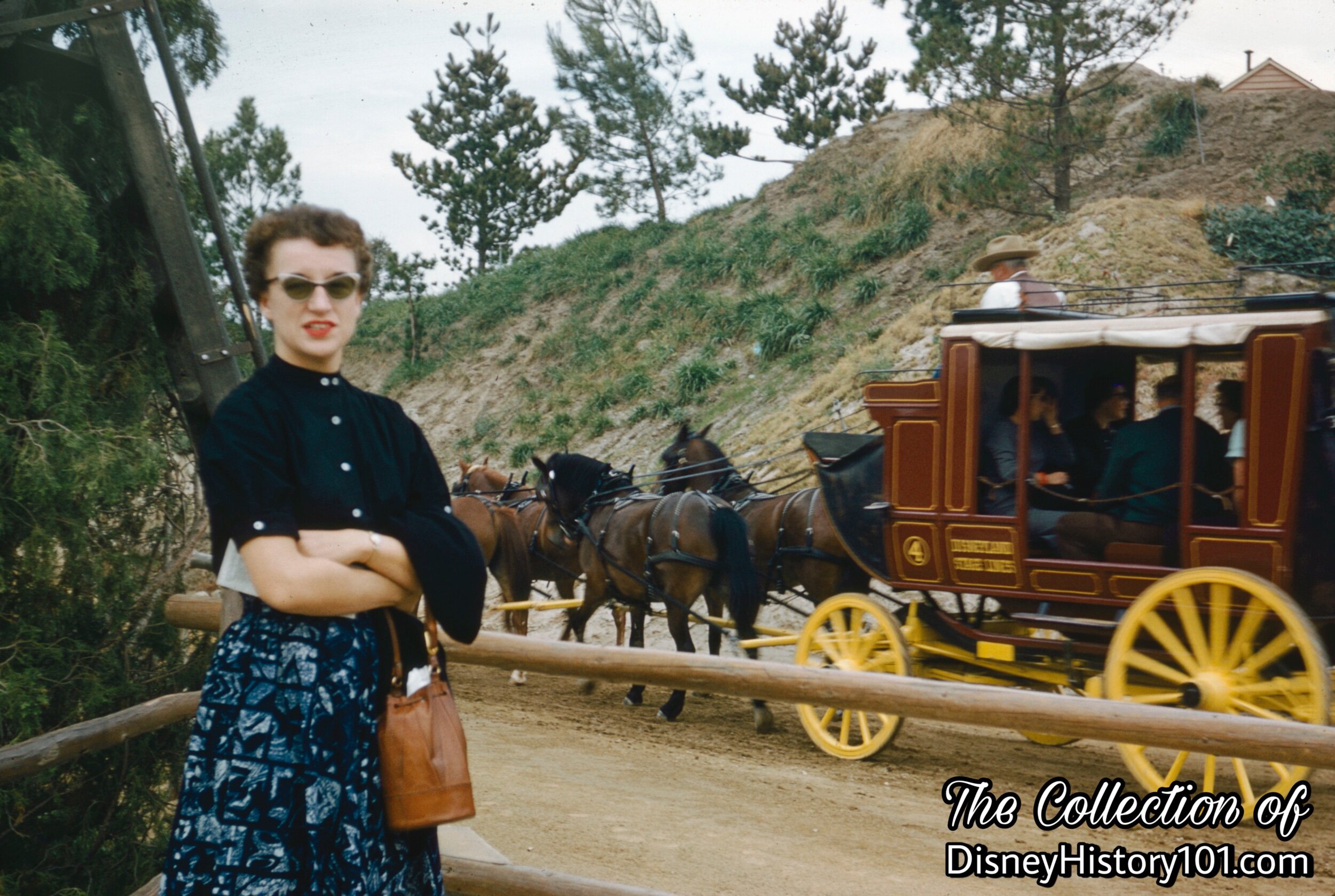

The rails of the Santa Fe & Disneyland Railroad also ran through the Rainbow Desert, offering a view of the wonders of the desert, as well as their trafficked roads.

One of several wonderful ways to see the Rainbow Desert is immortalized on this souvenir panoramic postcard!
Before they disappeared, the Disneyland Stage Lines Coaches made a couple of appearances on film. One Stage Coach was utilized in filming a scene of Slue Foot Sue, Can-Can Dancers and the Traveling Salesman arriving at the Golden Horseshoe (perhaps on Saturday, October 5, 1957) for the “An Adventure in the Magic Kingdom” episode of Walt Disney’s Disneyland (airing in 1958). Perhaps this is when costume designer Renié Conley crafted costume concepts for the “Disneyland Frontier Land Stage Coach.”
The craftsmanship of the old Disneyland Stage Lines Stage Coaches was just too good, and the Stage Coaches were not disposed of, but brought back to Walt Disney Studios. They were soon featured within the second season “Talent Round Up” Roll Call act of the Mickey Mouse Club television show (featured from 1956 to 1957).
During 1959, one of the Rainbow Mountain Stage Coaches was notably utilized to transport celebrity Richard Eastham (of Tombstone Territory fame) along the route of the “Disneyland ‘59” pageant and parade! A few months later, the Rainbow Mountain Stage Coaches took their last excursion through the Rainbow Desert, and then closed on September 13th, 1959. By this date, a grand total of 1,350,589 guests had the privilege of riding aboard one of Disneyland’s Concord Stagecoaches!

A covered wagon appeared in the Press Preview Day Parade. Frank Pfannenstiel recalled “the covered wagon going down Main Street on Opening Day, with Fess Parker and the governor of Tennessee.”
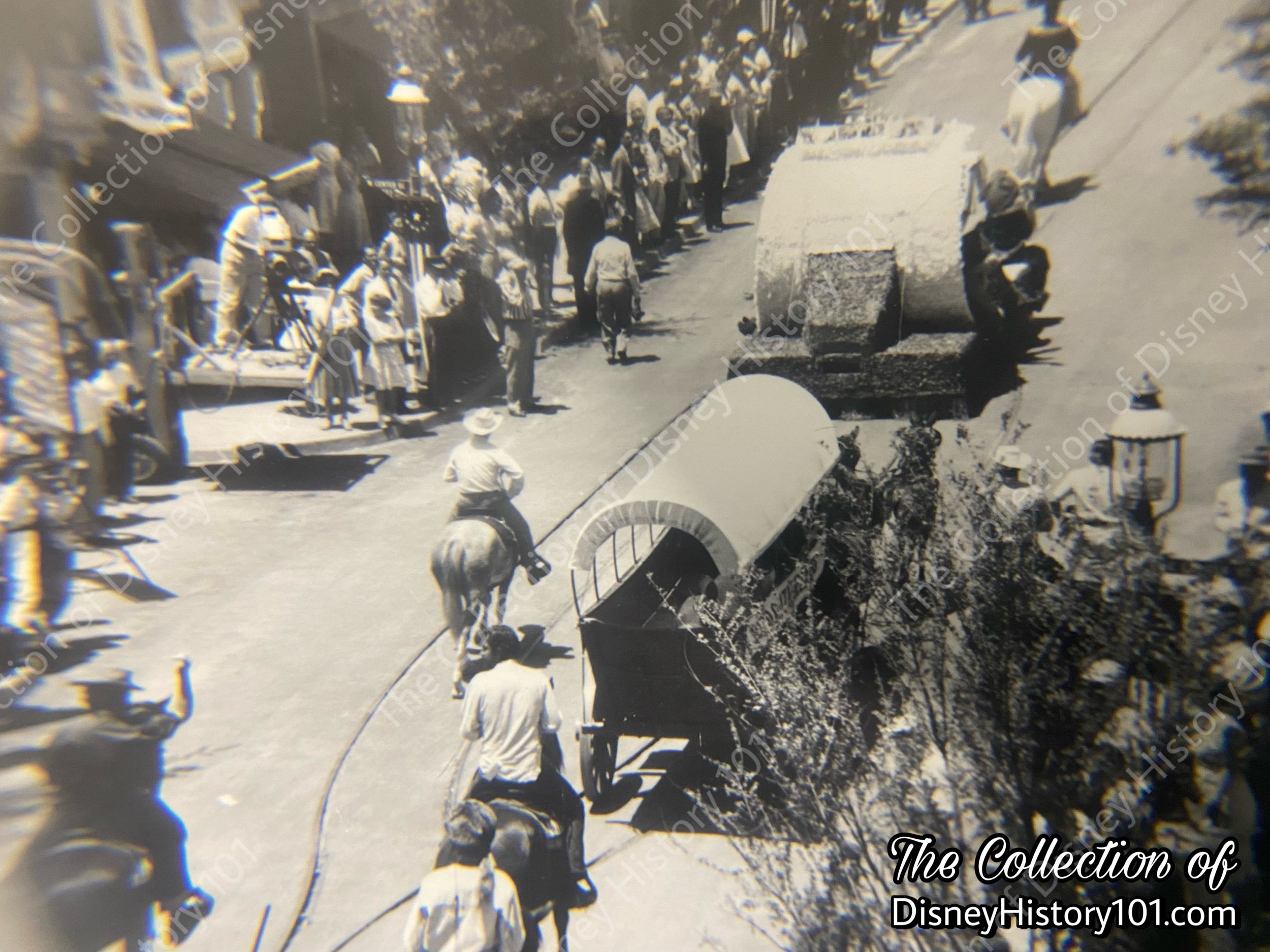
Very soon, “to provide transportation throughout Disneyland, the almost forgotten art of wagon making was revived. We built Conestoga Wagons…,” according to the narrator of “Disneyland - The Park,” a Disneyland anthology series episode (first aired 1957) which briefly preserves the construction of the Conestoga wagons. After Walt Disney Productions’ Westward Ho the Wagons! “wrapped” production (and was released during December of 1956), some props were utilized in the Disneyland Indian Village. “Cross-pollinations” (between Walt Disney’s studio and Disneyland) were commonplace during the 1950s and 1960s. Free exhibits in Tomorrowland and Main Street Opera House would feature props and sets of Walt Disney Productions’ feature length films (like, “20,000 Leagues Under the Sea” and “Babes in Toyland”) and Walt Disney’s Mickey Mouse Club television variety show. As for the Conestoga Wagons featured in the production of “Westward Ho!,” some were redecorated to match the theme of the feature film, reading “Westward Ho!” and “Oregon or Bust!” on the cover.
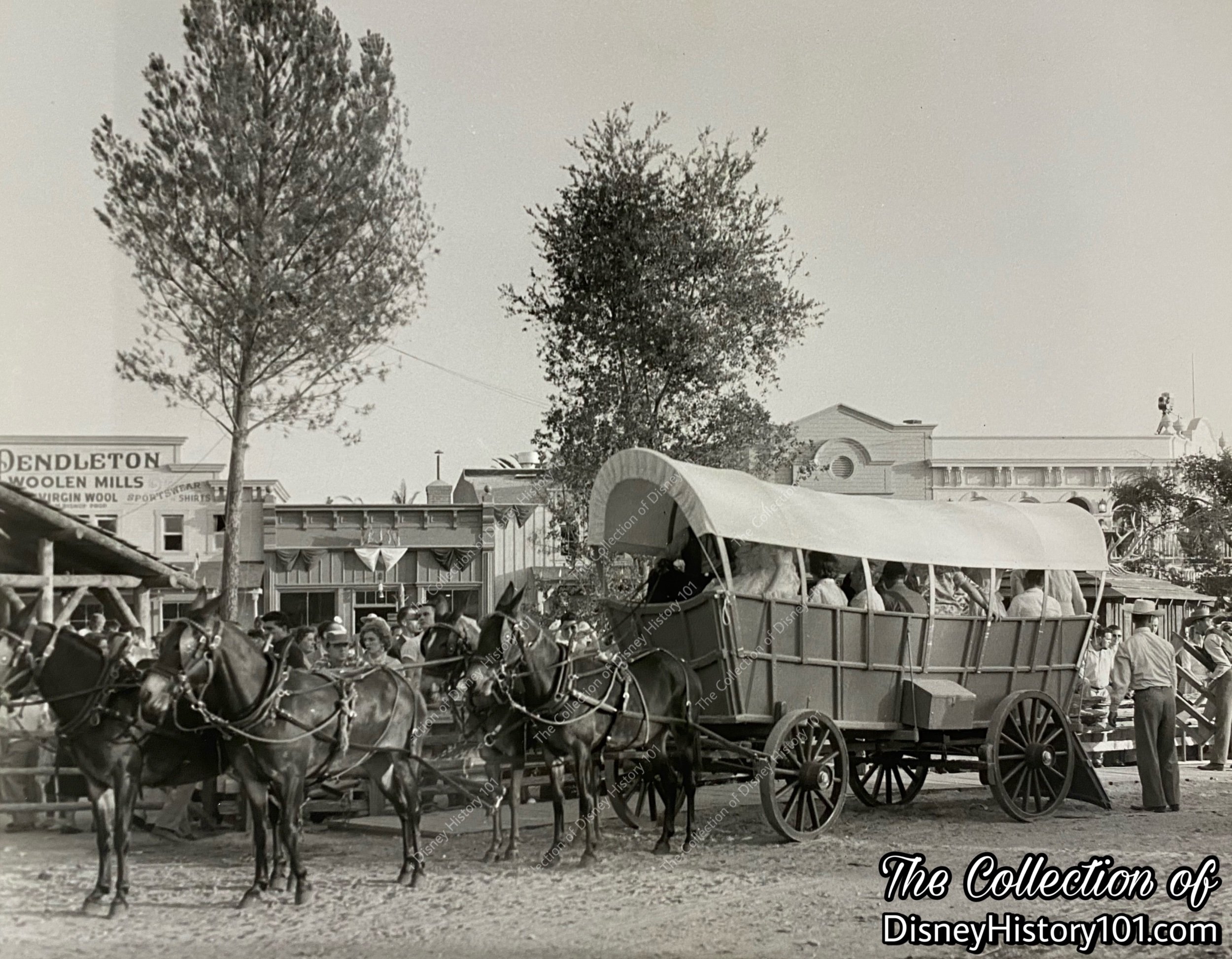
To pull these 5/8-scale vehicles along desert dusty road, over bridge, and across ford also required the breeding of specially-bred scaled-down equine. Some of these mules (of the Backstage Pony Farm) are briefly preserved on film, in “Disneyland - The Park,” a Disneyland anthology television series short film (originally aired in 1957). According to a “Nomenclature List” (updated May 25, 1955), there were “2 wagons and [sic.] a six mule hitch per wagon.” Both of these Conestoga Wagons officially enter the Frontierland Stockade during the live ABC Broadcast on July 17th, 1955.
![Now (a month after Disneyland’s first day of operation), “ Along [Frontierland’s own stretch of the] Oregon Trail” , the “wringle, wrangle, jinggy, jong, jangle” of the Conestoga Wagons ’ mighty fine equine (and their gear) were heard from August](https://images.squarespace-cdn.com/content/v1/5b3d7f804eddec6e826be0c9/1685204676011-9JHNZI48KVDJ7WN893KY/DAC3A0D0-9C62-4B79-B060-409BC87033D9.jpeg)
Now (a month after Disneyland’s first day of operation), “Along [Frontierland’s own stretch of the] Oregon Trail”, the “wringle, wrangle, jinggy, jong, jangle” of the Conestoga Wagons’ mighty fine equine (and their gear) were heard from August 16, 1955 to June 14, 1959. In these new vehicles, passengers were put in the middle of another true-life adventure - an alternate experience of the Painted Desert attraction in Frontierland, and a better understanding of how some early Americans moved west!
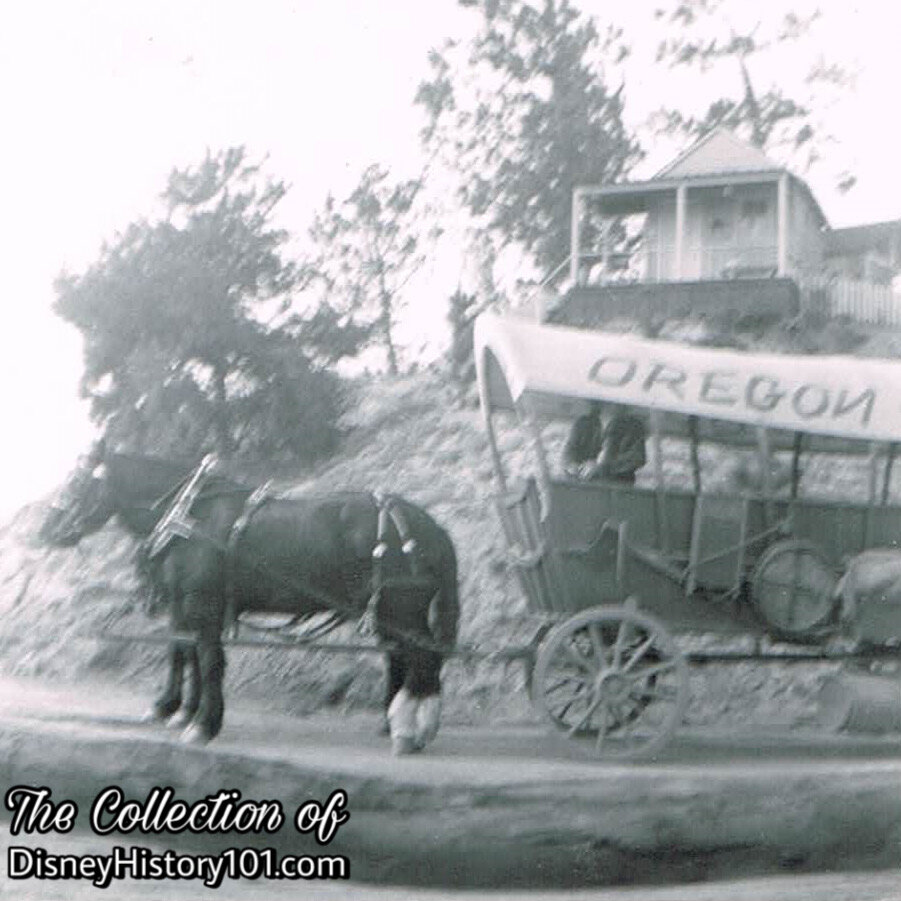
We’ll depart the false-fronted store buildings and hitching rails of the town for a trek out west!
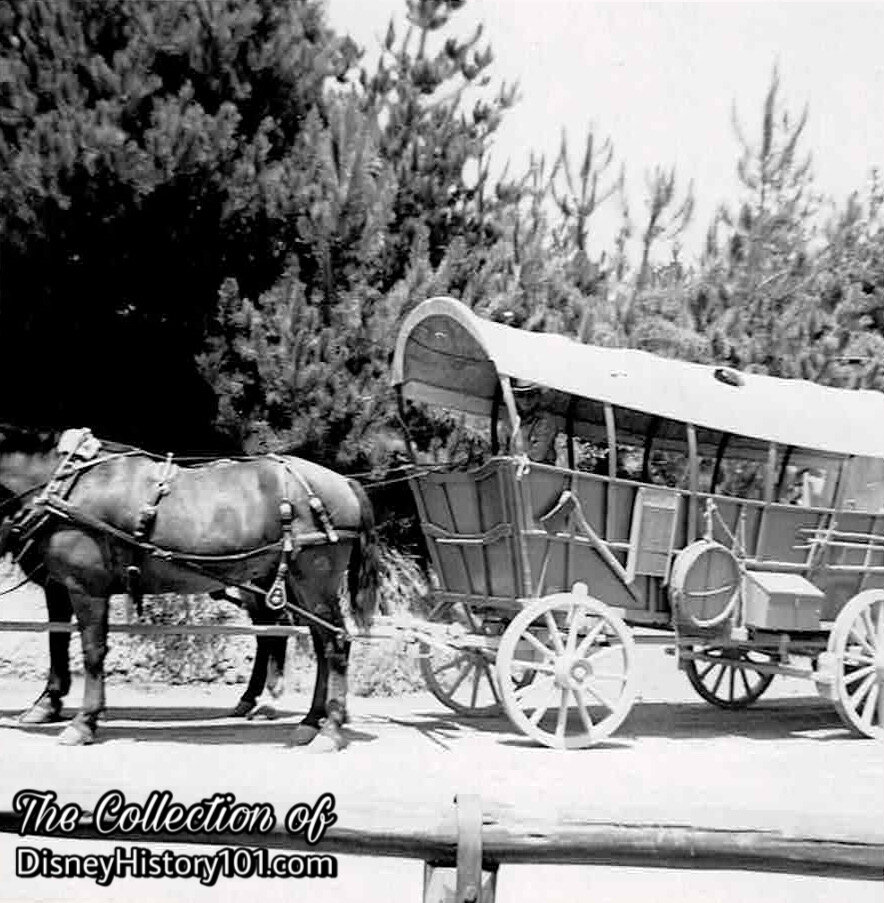
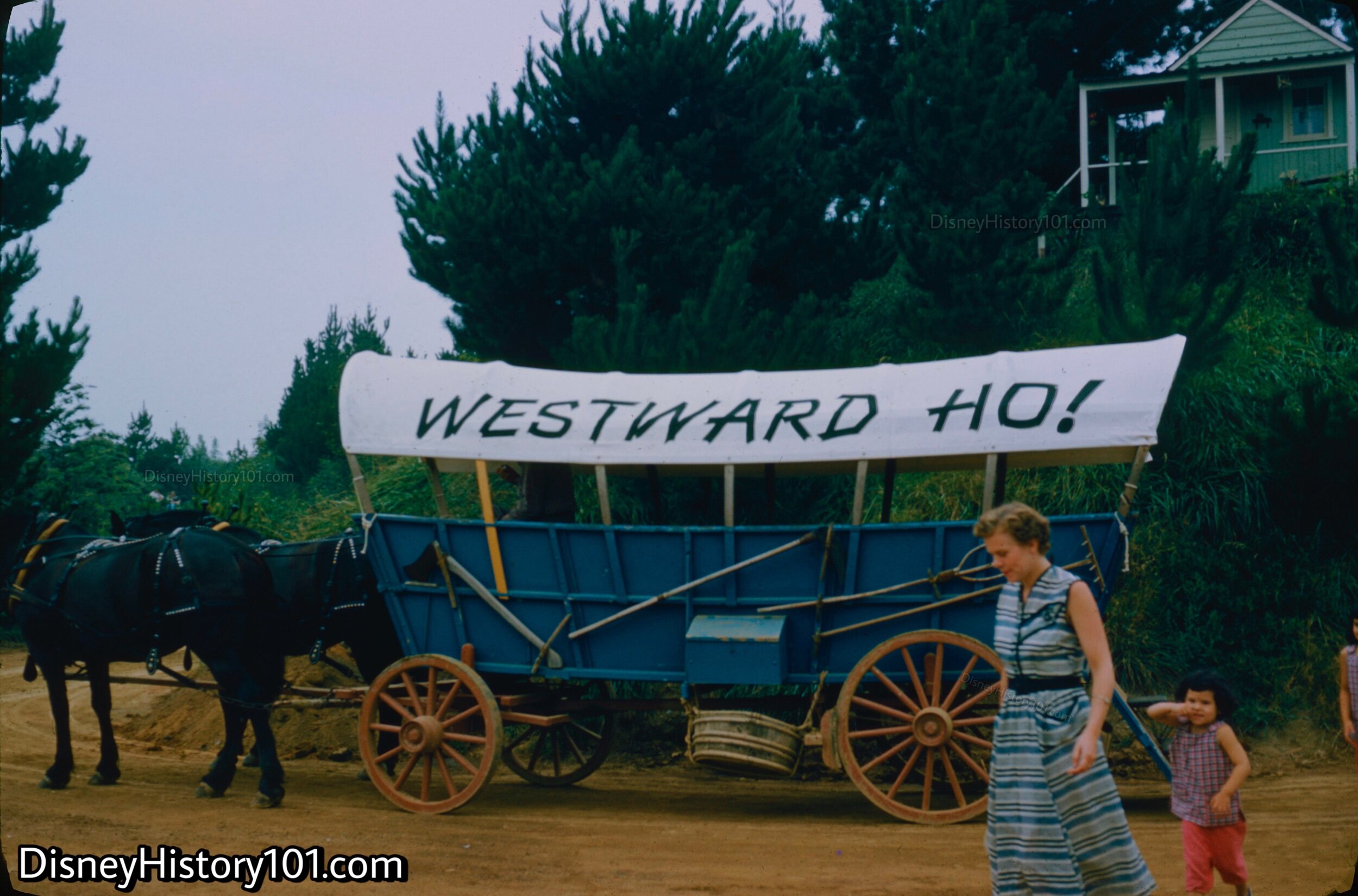

Once upon a time, Mule Packs, Conestoga Wagons, and Stagecoaches transported guests through the Rainbow Desert.

The original cost of passage through the desert aboard one of the Conestoga Wagons was one “B” Coupon (or, 25 cents).
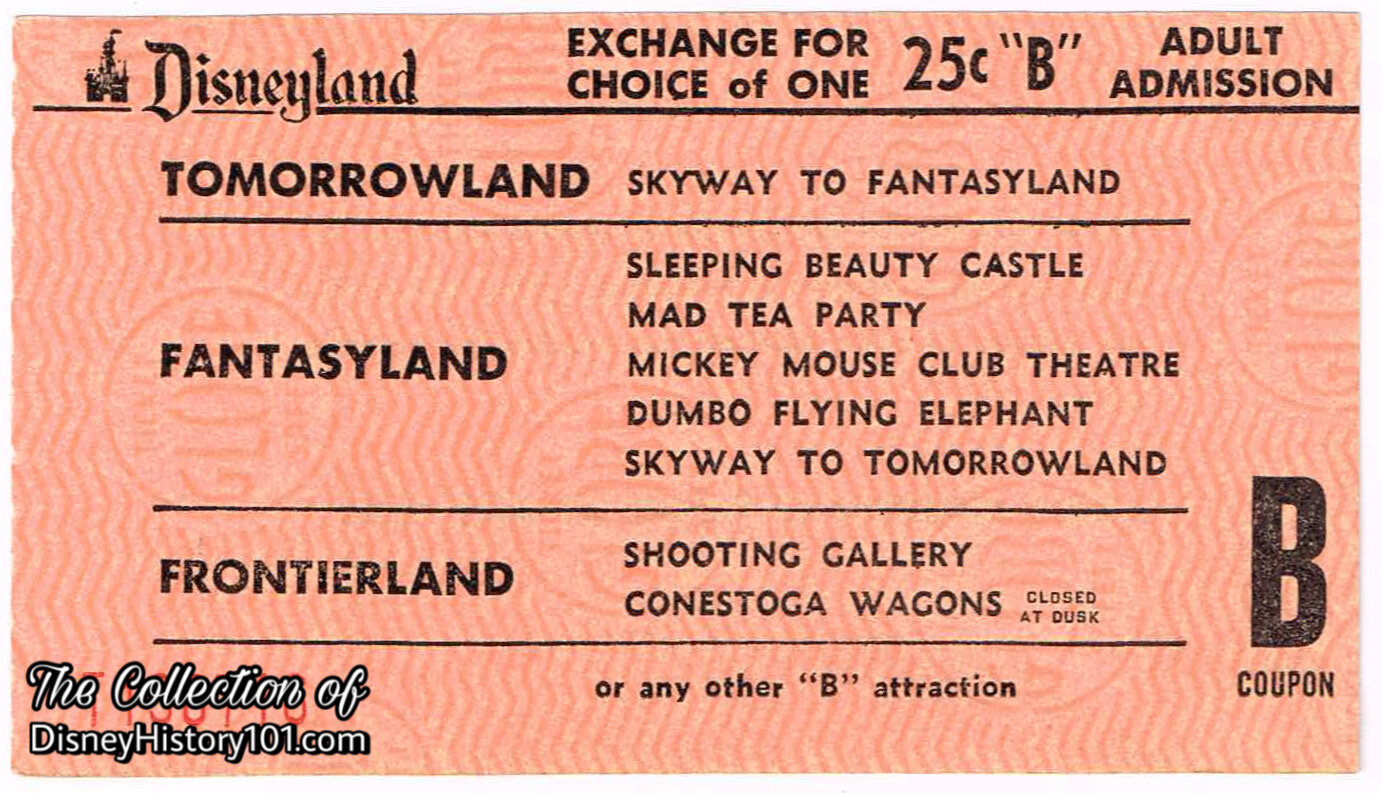

Admission for the Conestoga Wagons (during 1957) was one “jumbo” “B” coupon (or, 25 cents, for one adult), the same as a round of ammunition in the Main Street Shooting Gallery, entry into the Mickey Mouse Club Theater, or a ride aboard the Fantasyland Viewliner or Tomorrowland Viewliner!
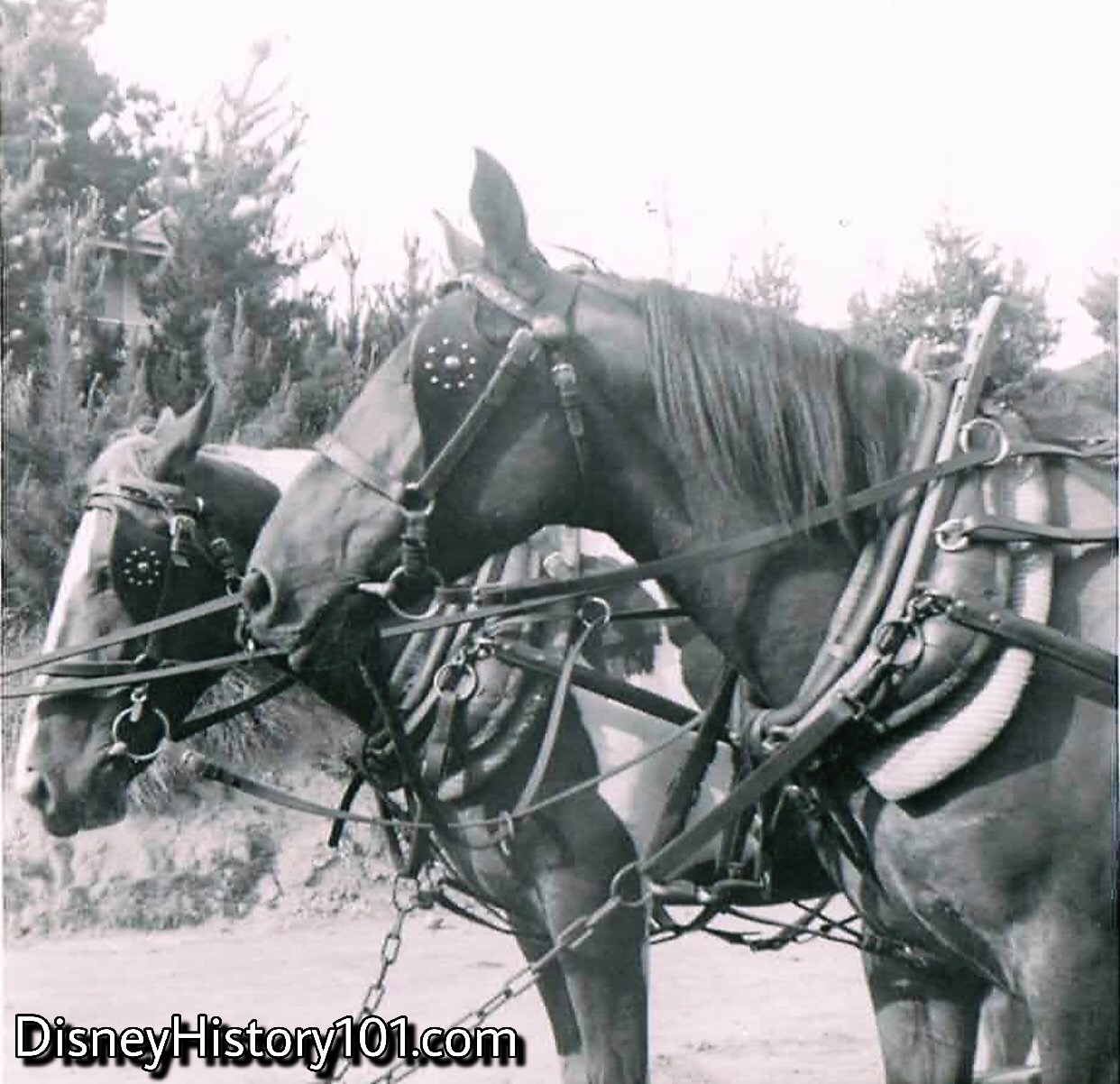
Before we step aboard we take a look at our faithful horses that are hitched to one of the Conestoga Wagons (those old “Prairie Schooners”). We’re mighty careful not to spook the horses, as we note the beautifully hand-crafted tack (brow bands, bridles, collars, and other harness parts) which were created under the direction of Owen Pope, and will generate the “wringle” and “wrangle” as the horses head down the dirt road.
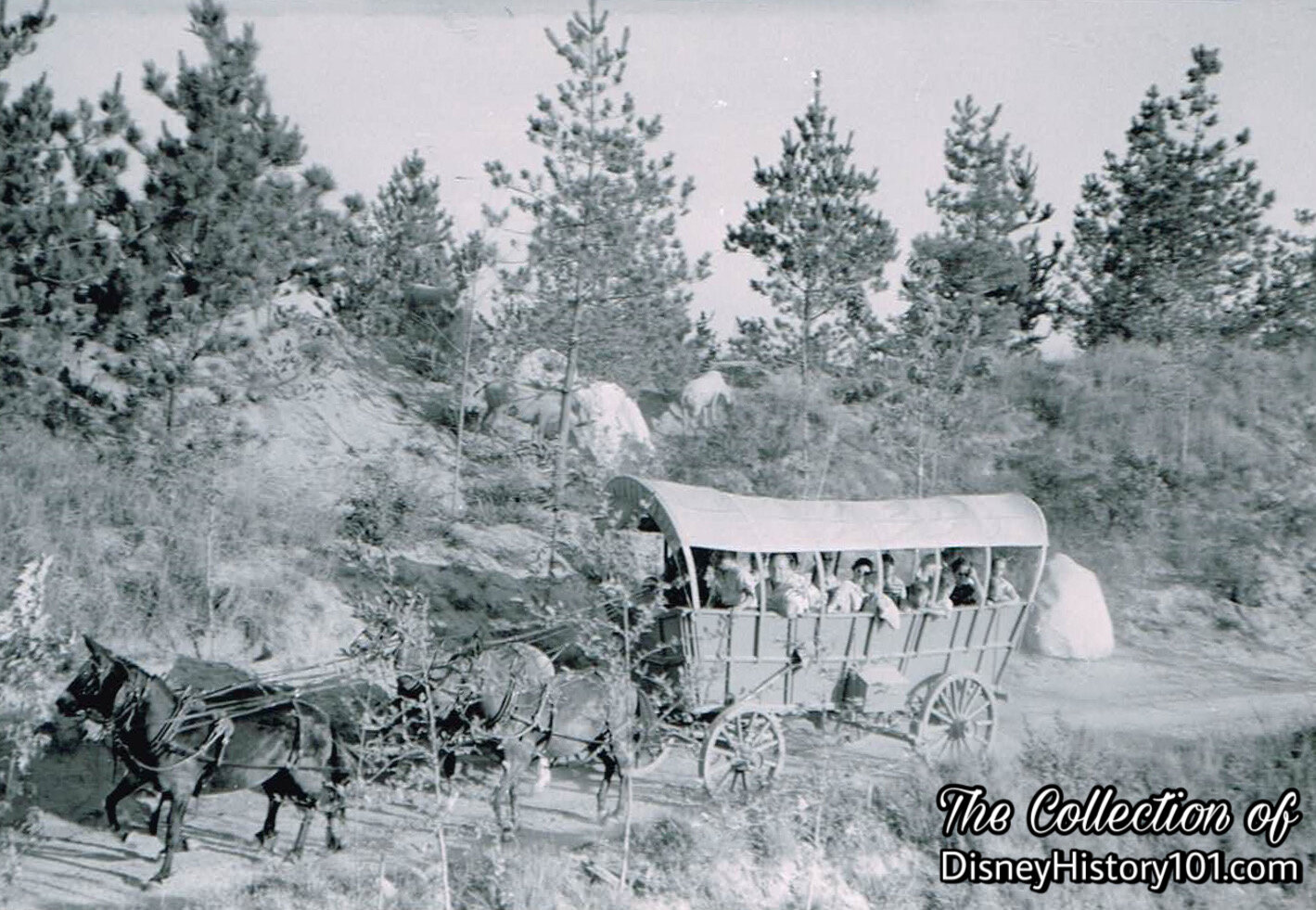
In the hills, “children of the covered wagon” pass pines, oaks, and olive trees.

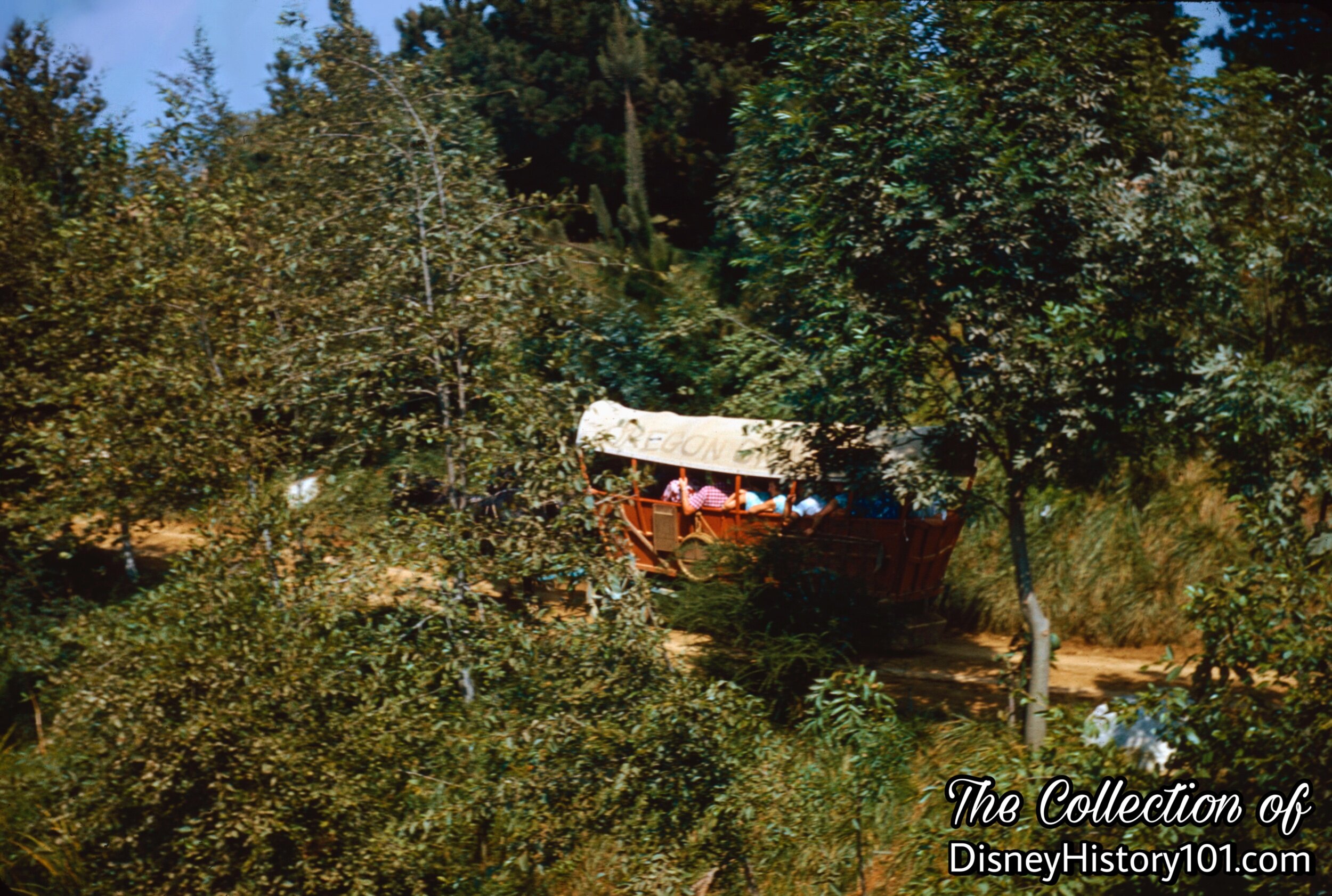
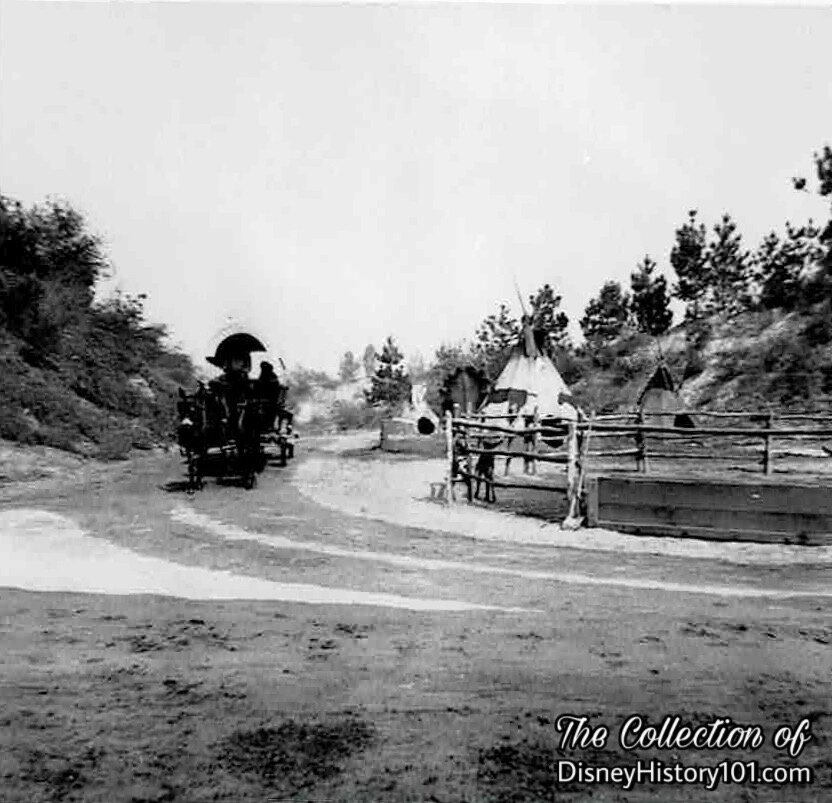

You’ll recall that Owen cared for both the animals and the equestrian equipment on the 10-acre Pony Farm, in Backstage Disneyland. Note one of the Conestoga Wagons on the service road behind the Mule corral. “55er” Day Sechler recalled: “At Disneyland, … Walt [sic] came to the Pony Farm a lot to watch us break horses. He was always concerned if he could do anything for you.”
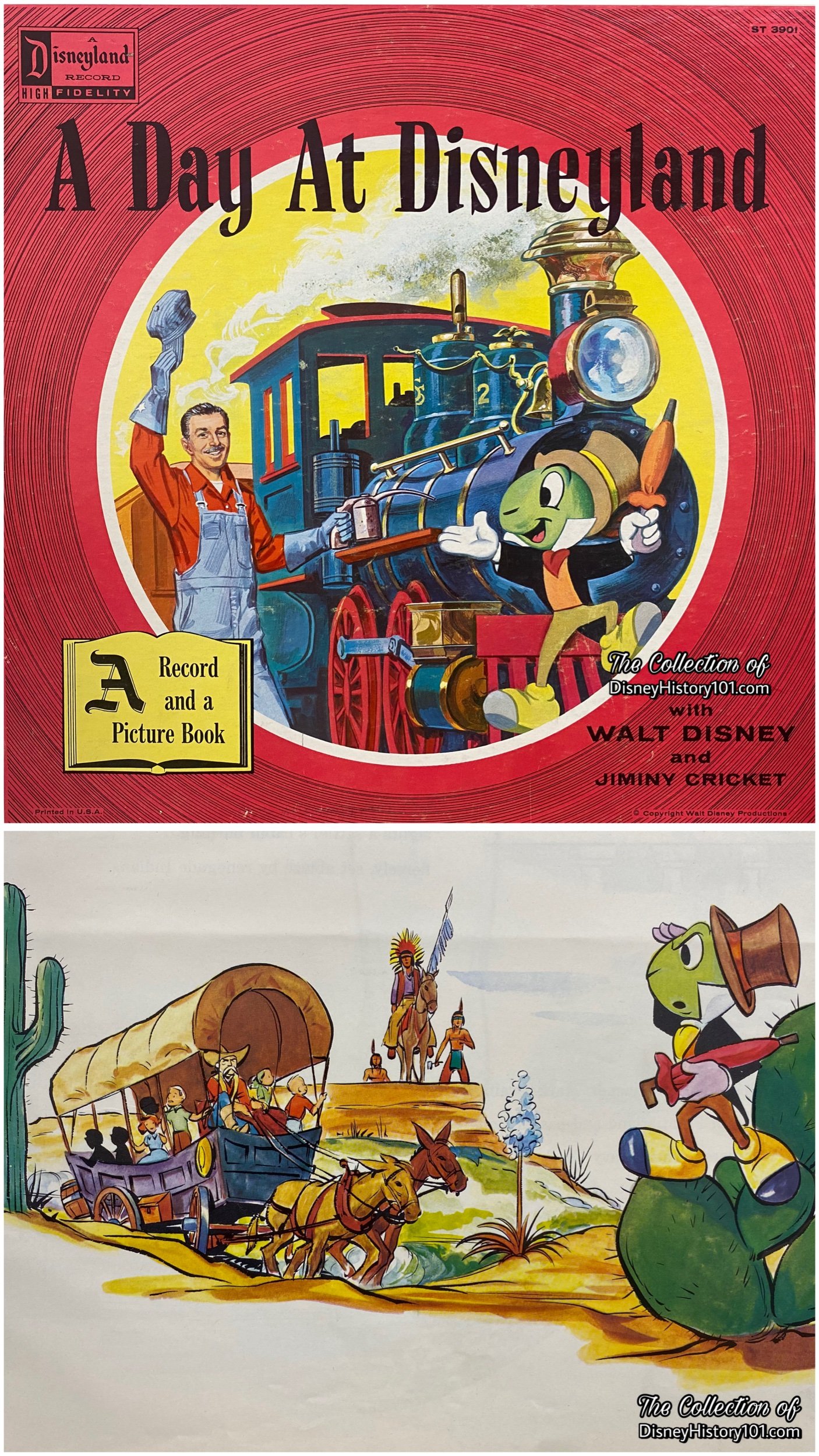
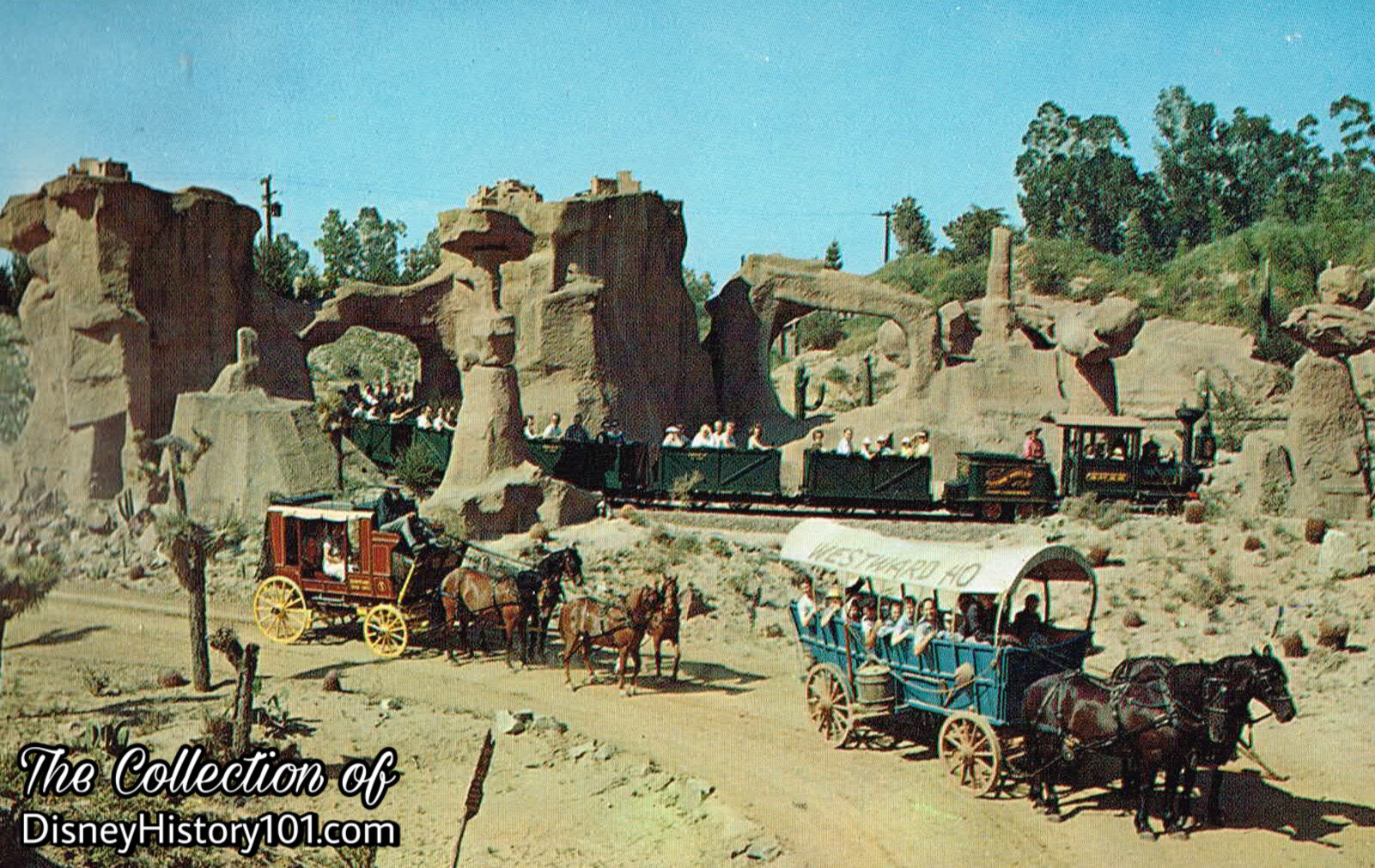
This rare Disneyland Postcard features a rare sight one of the Rainbow Ridge Mud Wagons, a Conestoga Wagon, and one of the Rainbow Mountain Mining & Exploration Co. trains! Art would soon imitate life, when the more archaic forms of desert transportation would make way for the steam-powered future! For now though, engineers of those engines were mighty careful about their whistle-blowing, so as to prevent spooking the equine that pulled the horse-drawn vehicles.
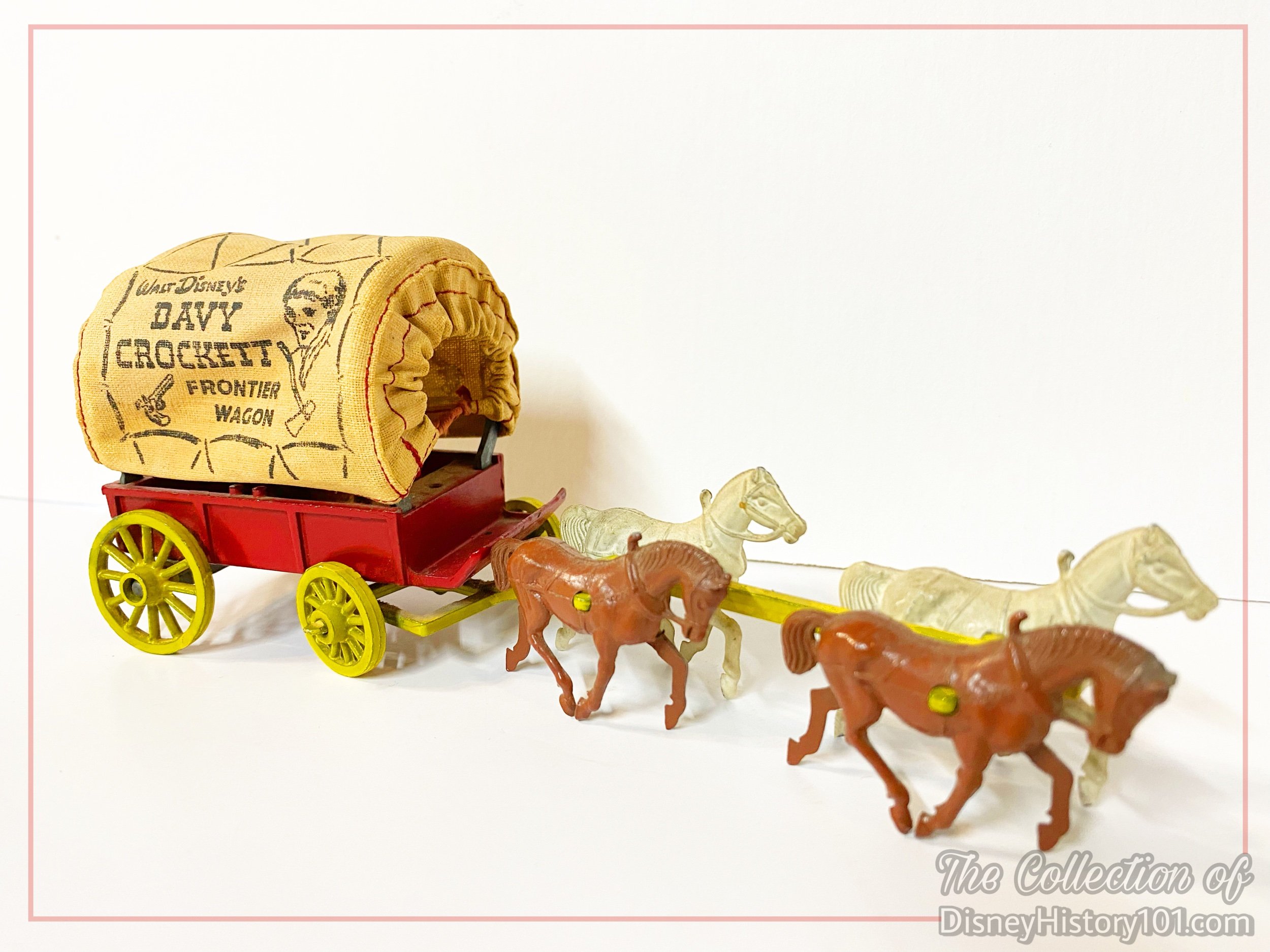
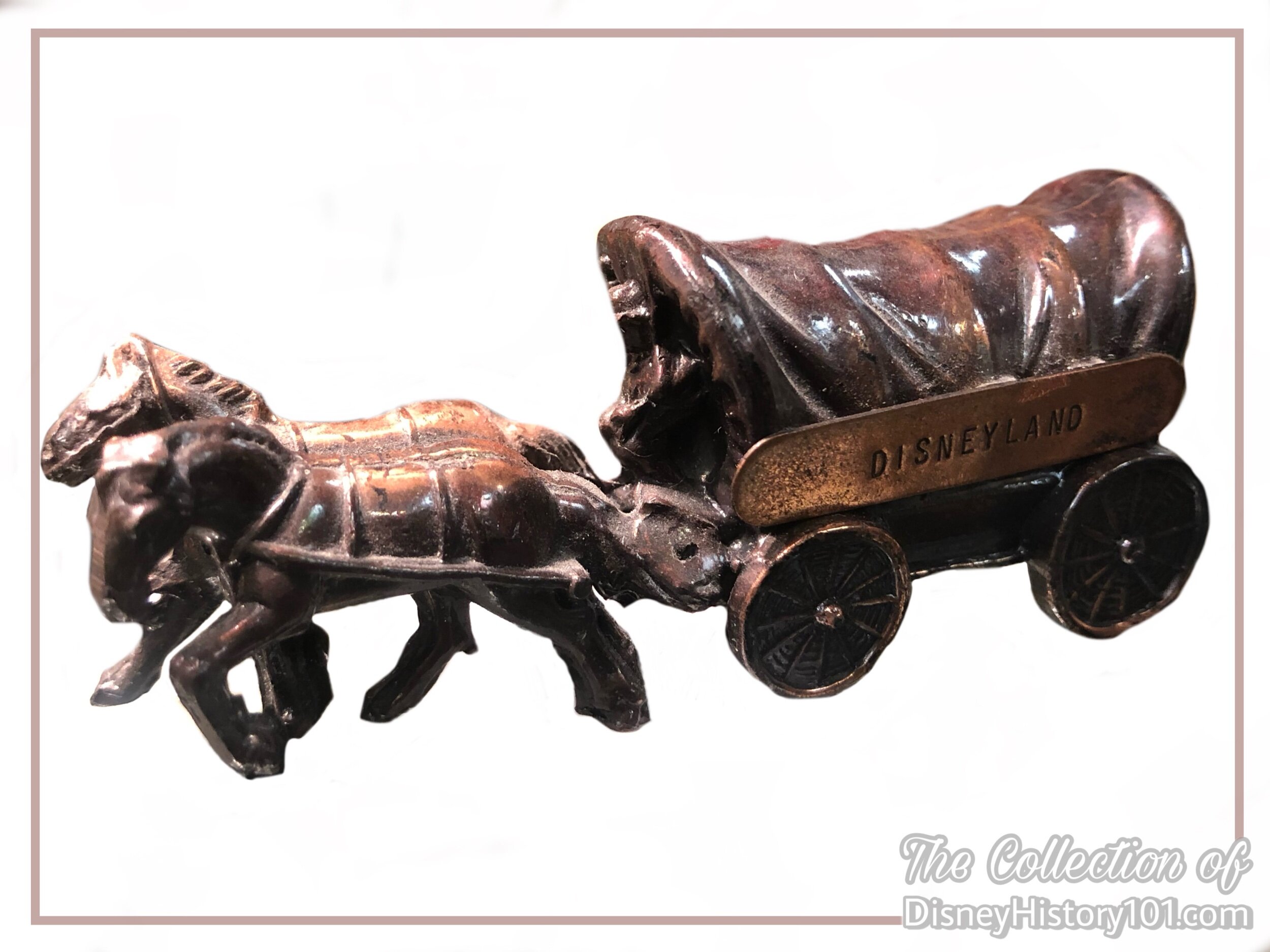
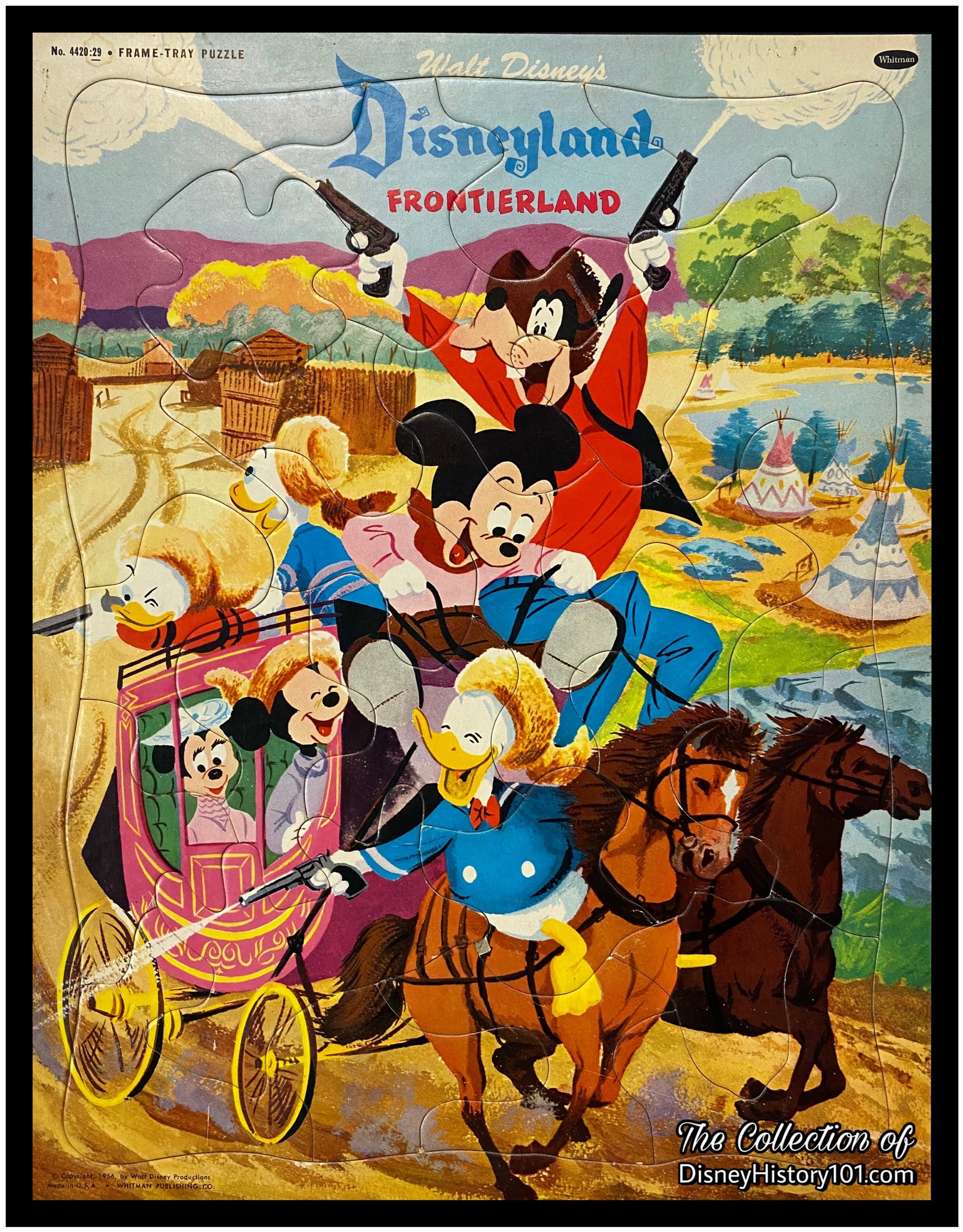

By 1959, Joe Fowler was Vice President of Disneyland Operations Committee and Doc Lemmon of Disneyland Operations was overseeing Operators of Rides & Amusements (like the Conestoga Wagon and Rainbow Mountain Mud Wagon Coaches), Livestock, Parking Lot, and Ticket Sellers. By that time, Disneyland Admission media “C” Coupons (above) equated the value of a ride aboard the Rainbow Caverns Mine Train with the alternate desert route of the Conestoga Wagons.
“Incidents & Liability”
Owing to incidents, by September of 1958, Disneyland, Inc. had a liability - a Public Liability and Property Damage Insurance Policy valued at $ $80,250 (according to an appraisal by Bank of America). By 1959, Disneyland, Inc. had many more types of insurance policies. Disneyland, Inc. had “liability property damage” at coverage of $500,000 per person and $2,000,000 per incident, $500,000 on property and $2,000,000 on aggregate products, at an annual premium of $165,957. Disneyland, Inc. had also increased its “multiple perils” insurance policy coverage twice; from a coverage of $6,000,000 for 5 years, increased by 3,700,000 for 4 years, and increased by 490,000 for 3 years. After all, the policy had a coverage of $10,190,000 at an annual premium of $9,717. Despite the coverage, incidents would occur that would result in the end of an era for the Disneyland stage coach and its route!
Milo Rainey recalled: “Sometimes runaways would be caused by ducks flying across the river.” Day Sechler recalled: “We were loadin' a stage coach one time when we looked up and people were hollerin' and yellin' from the MARK TWAIN, pointin' at a stage coach with four ponies on the dead run- and NO DRIVER! They ran into a coach that was loading and turned it clear over on its side - with JIM LINDSEY UNDERNEATH!”
Day Sechler also recalled: “Another time, a coach turned over with 17 people when a shot of steam from the train scared the ponies at Rainbow Bridge. A safety device released the coach from the front wheels. It sure was a sight to see the ponies come racing home draggin' only the 2 front wheels!”
According to a related newspaper headline (published just after the latter incident), “Eleven [were] injured as horses bolted at Disneyland.” The same article continues : “Eleven persons including six children, suffered minor injuries Monday at Disneyland when the four-horse team of a stagecoach bolted. The injured were the driver and 10 of the 12 passengers in the stagecoach at the amusement park. Several were thrown to the ground when the stagecoach collapsed after its undercarriage was torn off by the wild horses. A Disneyland spokesman said the horses became frightened at the sound of the Park’s train whistle.”
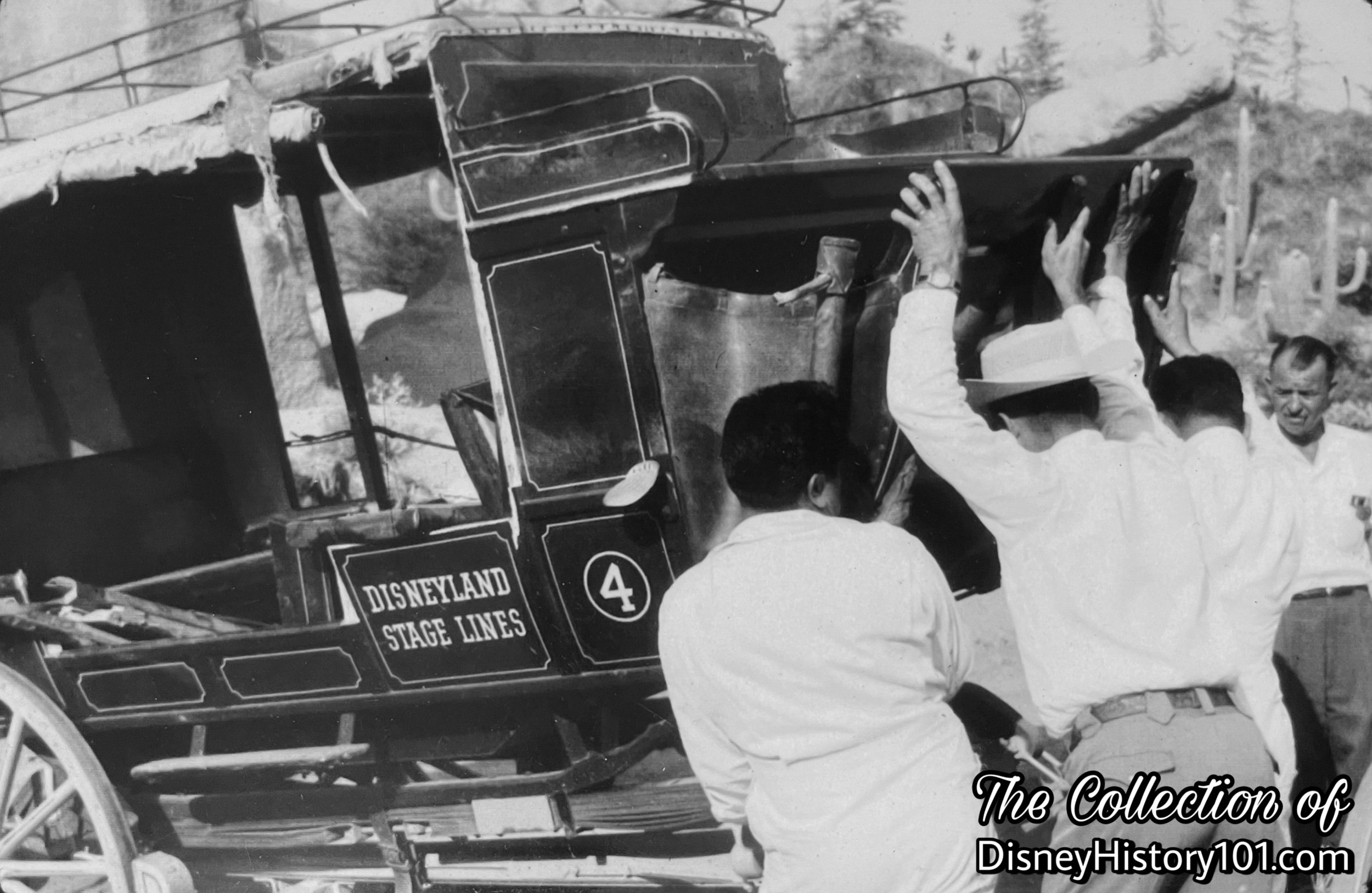
A few months later, another article (by Bob Thomas of the Associated Press) divulged Walt’s thoughts over what had occurred. “‘We had stagecoaches riding through the Painted Desert area’, he explained. And we had a few minor accidents on them. Nothing serious, but enough to worry me. We have a fine safety record at the Park, and I wanted to keep it that way. So I redid the desert to do away with the stagecoaches.”
This decision may not have been easy for Walt. Years later (in 1973) an interview with Joe Fowler perhaps revealed Walt’s feelings over the stagecoaches going “101”: “You know, I could go on for hours with the great understanding that man had and the things he loved and the way that he recognized that he had to make compromises. One of the things he loved, I guess, more than anything else was the stagecoaches that we had, the six horses in Frontierland. Well, we had three accidents. The damn thing was top-heavy where we'd put the people on top of the coach as well as inside. Of course, a horse is the one thing that, as Owen Pope will tell you, you can't predict. He may go along three hundred days and then suddenly bang! He shies at some damn thing. And it was a problem with these horses. We'd had three accidents and fortunately no injuries, but there might have been people killed. I went to Walt and I said, ‘Walt, I'm sorry but we just have to take the people off the top of the stagecoaches or we’re going to have an accident. We've had three near ones!’ Walt said, ‘Oh, Joe, if we don't have the people on top of the coaches, it's no show. Besides the damn horses are gettin’ their heads off. Let's discontinue it and have the mule ride,’ which we did. But I knew him well enough by that time to know what it cost him.”
It may as well be a “Safe ‘D’ Fact” that if an attraction at the Park proves to be dangerous, the problem is corrected or the attraction is eliminated. Dangerous attractions just aren’t “Good Show” as they do not support a positive Disney image. So, the stagecoaches would experience a “Show Failure” situation and go “101.” After three tip overs, Walt Disney got rid of the ride.
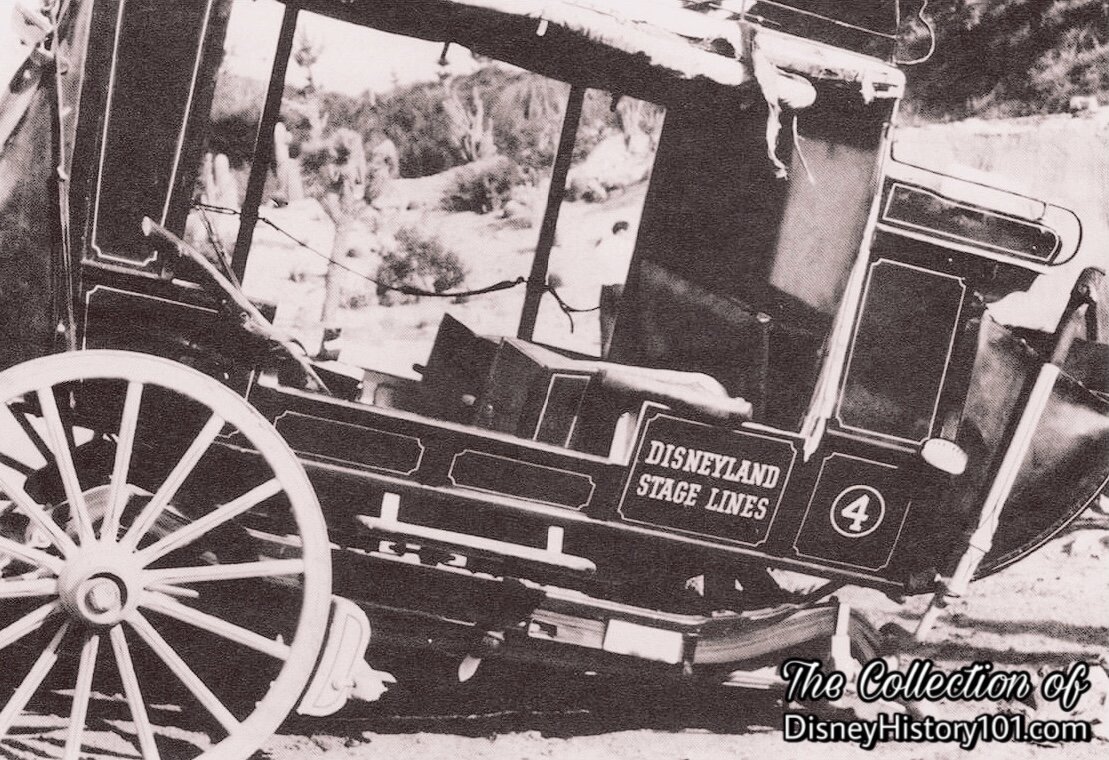
There wasn’t a “pioneer’s prayer” that could help Disneyland Stage Lines “Mud Wagon” Coach #4 ever go “102” again. However, not withstanding these incidents, one of the Rainbow Mountain Mud Wagon Coaches was still notably utilized to transport celebrity Richard Eastham (of “Tombstone Territory” fame) along the route of the “Disneyland ‘59” pageant and parade! But alas, the Conestoga Wagons would suddenly ceased operation on June 14, 1959, ahead of the Rainbow Mountain Mud Wagon Coaches. By the end of their run, a grand total of 560,646 guests had experienced dessert passage aboard a Conestoga Wagon. A few months later, the Rainbow Mountain Mud Wagon Coaches took their last excursion through the Rainbow Desert, before closing on September 13th, 1959. By this date, a grand total of 1,350,589 guests had the privilege of riding aboard one of Disneyland’s Concord Stagecoaches and Disneyland Stage Lines’ Mud Wagons!
While some publications (like the “Golden Magazine for Boys and Girls”, June of 1965) mistakenly still included photos of the stage coaches in descriptions of Frontierland within their pages, this was “the end of the trail” for the Conestoga Wagons, the Rainbow Mountain Mud Wagon Coaches, and their desert routes. However, it wasn’t the end of the Rainbow Desert territory. In fact, construction was now brewing, regarding a large refurbishment centered around one of two wonderful ways to explore Frontierland’s Rainbow Desert - the Rainbow Caverns Mine Train! But, that’s another story, for another time. (However, if you wish, you may STEP THIS WAY to explore the history of the Mine Train Thru Nature’s Wonderland.)
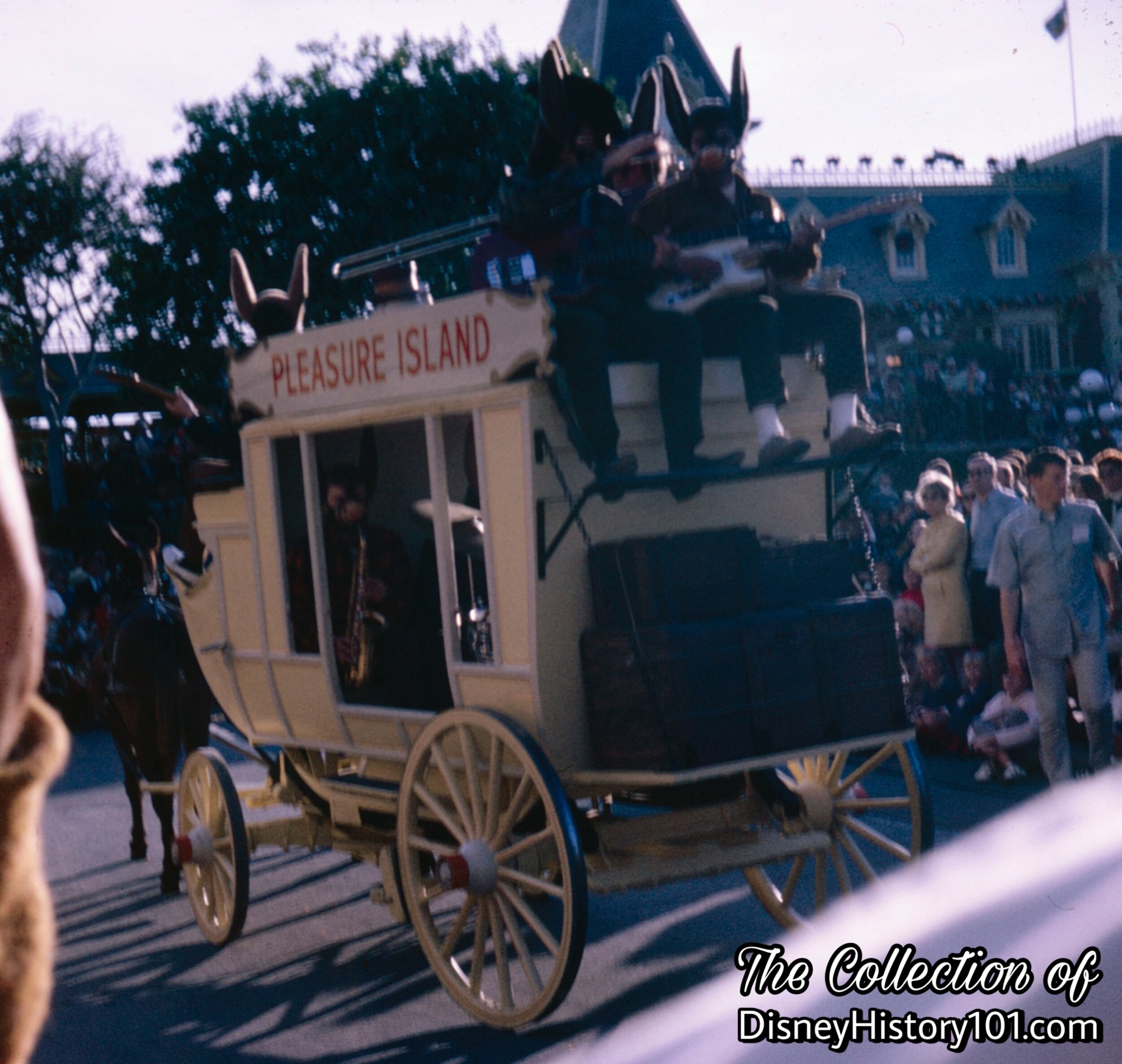
“Legacy”
Owen Pope regularly oversaw the acquisition and fabrication of equestrian-related parade vehicles (like the Scarecrow Band Hay Cart for Fantasy on Parade of 1965). In addition, through special arrangements, Owen’s pony teams often pulled some of the vehicles (like the Biggest Bass Drum).
Even some ten years later, one of the old Disneyland Stage Mud Wagon Coaches was repurposed (likely under Owen’s oversight and direction) as a parade vehicle for a Pleasure Island Unit of a seasonal winter holiday parade. This time, the equines also rode in the body, driver’s box and shotgun.
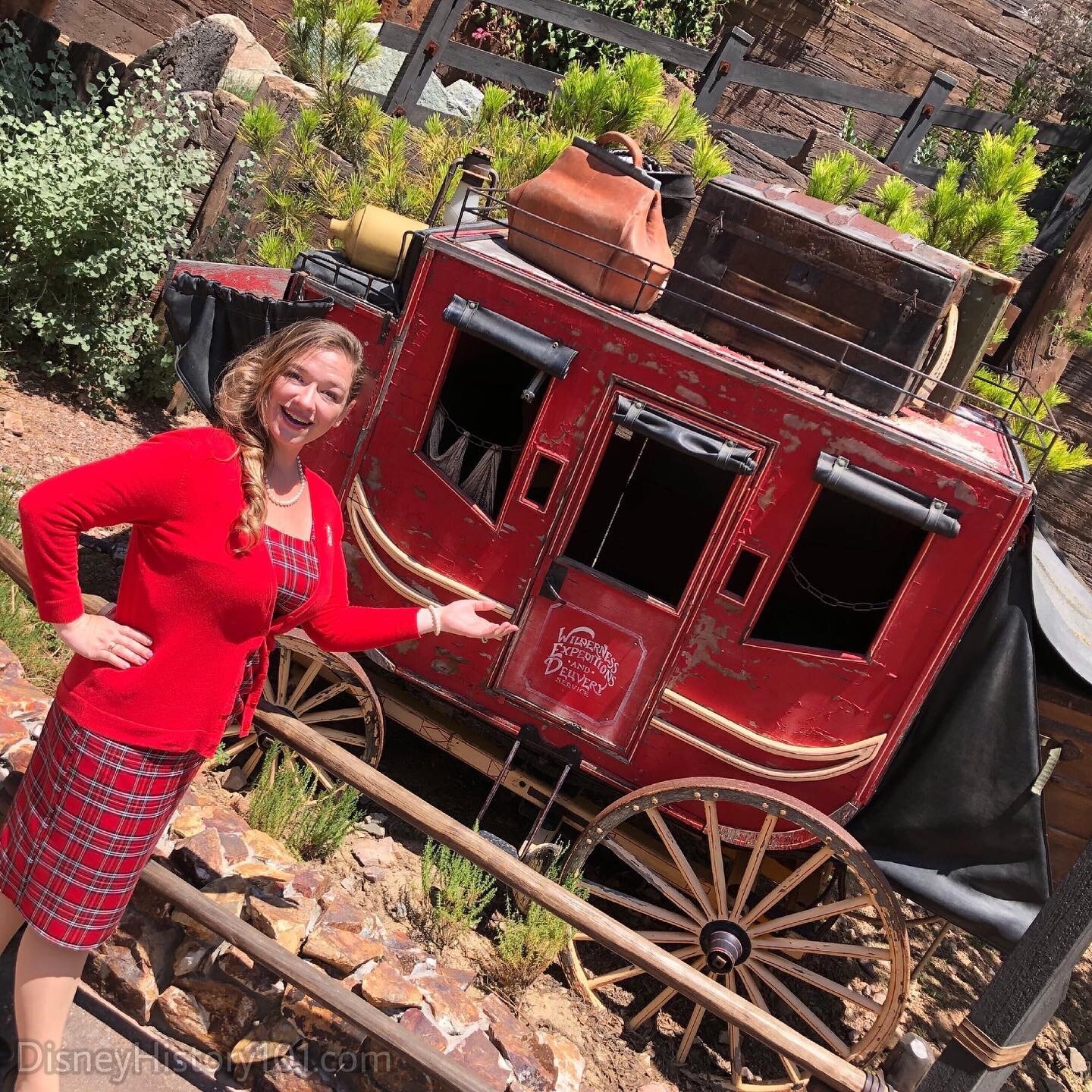
In the present, Stagecoaches haven’t completely disappeared from Disneyland altogether. During the stages of “Project Stardust,” this stage coach came to sit alongside one of Frontierland’s main roads. It may look similar in style to the Stagecoaches that operated out of Rainbow Ridge (from 1955-1960). However, it is surely not one of them. There are numerous differences between the overall shapes of the bodies, the wheel hubs, railings, and overall cargo sections, to name a few differences. Rumors abound that this is one of the neighboring Knott’s Berry Farm’s stagecoaches, yet we are still in search of a source to validate this claim.
Still, this stagecoach carries several story references to Frontierland elements! First, the words “Wilderness Expeditions and Delivery” appear on the doors - an acronym that (when abbreviated) spells “WED.” Maybe you’ve also noticed the name of Tony Baxter’s original Big Thunder Mountain Railroad character Jason Chandler, referenced on a luggage tag on the back of the Wilderness Expeditions and Delivery Service Coach. According to legend, Jason Chandler was the founder of Discovery Bay.
If you would like to see (what are perhaps) two of the last surviving true-life Disneyland Stage Lines vehicles(including the Disneyland Stage Lines “California” Stage Coach, which was previously on exhibit at the Park during the Disneyland 50th Anniversary ; and Disneyland Stage Lines Mud Wagon No.6), you will need to be invited to visit the Circle D Ranch in Norco, California.
In Florida, Walt Disney World Stagecoach Ride carried the Frontier tradition at Fort Wilderness.
ROYAL STREET BACHELORS

It has been said that “Disney magic” begins with the Disneyland Cast Member who support a “Good Show” - a positive Disney image! Since the beginning, Atmosphere Entertainment complimenting the theme of areas was staged to entertain Disneyland Guests on an immediate and personal level. A variety of live shows entertained Guests throughout the day.
“Disneyland revolutionized outdoor entertainment and established a new approach to showmanship. The concept of a living stage was a radical change from the conventional amusement park, fair or fun zone. A variety of live shows entertained Guests throughout the day.”During early years of Disneyland (1955 to 1965), Frontierland featured a riverfront path known as Orleans Street. One of the popular attractions along Orleans Street was the Dixieland Gazebo Bandstand, where several dixieland bands performed throughout the day and night. Of these, the most notable band was the Disneyland Strawhatters.
However, in 1966 new waterfront “land” (New Orleans Square) was introduced, and with that land came brand new entertaining Atmosphere units. One band in particular would have such a profound effect on New Orleans Square, that their image would become synonymous with New Orleans Square, and their name immortal. Yes, long before the Bootstrappers, or the Jambalaya Jazz Band, the original “one-of-a-kind” Royal Street Bachelors (occasionally billed as the “Royale Street Bachelors”) once performed signature Dixieland notes on the quiet streets and courtyards of New Orleans Square, Disneyland. INA Guides described their contribution to the Disneyland show as : “Sparkling, toe-tapping Dixieland melodies… heard in New Orleans Square from 11:00 a.m. to 6:00 p.m.”
Please step this way, as we meet both the founding and supportive members of the original Royal Street Bachelors, and learn a little about their work and legacy!

Jack McVea (November 5, 1914 - December 27, 2000) was the son of Los Angeles musician Satchel McVea (of Satchel McVea and his Howdy Entertainers). Owing to his father’s talent, Jack learned to play the banjo from the age of 12, and he also learned to read music. Even more, Jack soon became fond of playing both tenor and baritone saxophone (for which he is now, most remembered), and after leaving school, had the privilege to play with both Lee Williams and Lionel Hampton’s big bands.
In 1946, the door would open to Jack McVea & His All Stars, when they recorded the hit song “Open the Door Richard” on the Black and White record label. Though his group disbanded some years later, “fortuosity” was in his favor. Jack was specifically sought out by Disneyland, to contribute a New Orleans sound to the atmosphere of Disneyland’s future developement! A Disneyland Press Release divulged, “According to McVea, he was not much of a clarinetist but learned overnight to play three songs to secure the job.” After his diligence, he was hired immediately, and became the face of his Royal Street Bachelors.

Herb Gordy, was a cousin of music publisher Berry Gordy. From an early age, the left-handed artist became a skillful double bassist. He performed with Tiny "Mac" Grimes and the Rocking Highlanders. According to one account, “he also painted the edges of his bass in green phosphorescent paint. When Herb did his solo, they turned out all the lights, and the audience saw a ghostly green double bass dancing on stage.” This talent would provide the essential bass for the Royal Street Bachelors, and provide Herb a long career with Disneyland! If you’re a Cast Member, you may have heard the nickname of the large New Orleans Dressing Room - the “Herb Gordy Dressing Room” - in his honor.

Harold Grant joined the band after the passing of the original banjo player*. He had a talent for both banjo and guitar, and was featured in recordings (like Fred Clark’s “Ground Hog Snooper”, recorded 1953). Harold loyally continued with the trio for some 25 years. If you have any information or experiences involving Harold’s time with the Royal Street Bachelors, we hope to preserve more about his story here.
*The original Royal Street Bachelors banjoist is believed to have been a musician named Herman “Tiny” Burrell Mitchell). If you have any information or images leading to confirming his identity, please contact us. We would just love to preserve his story alongside those of his band members!
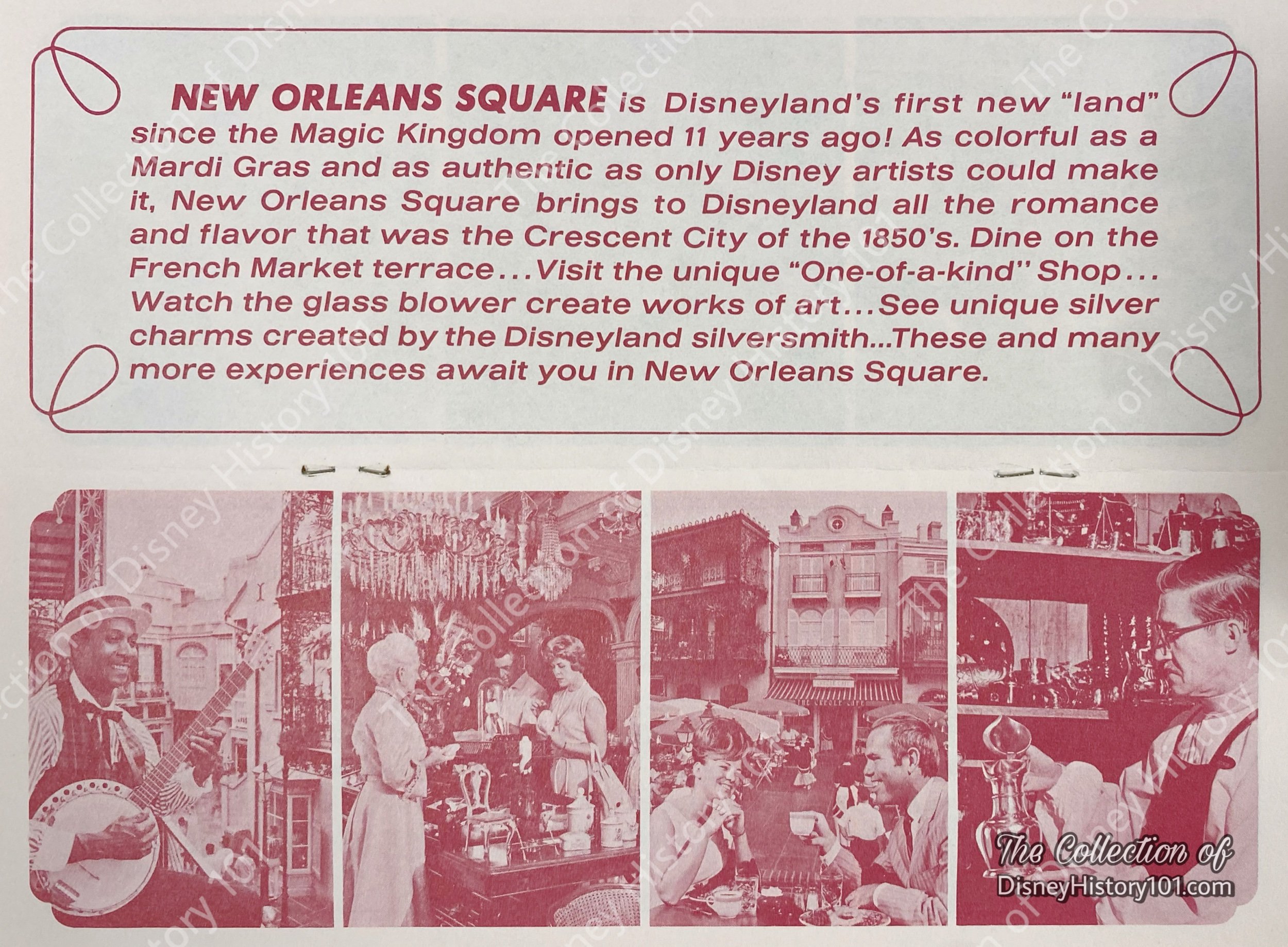
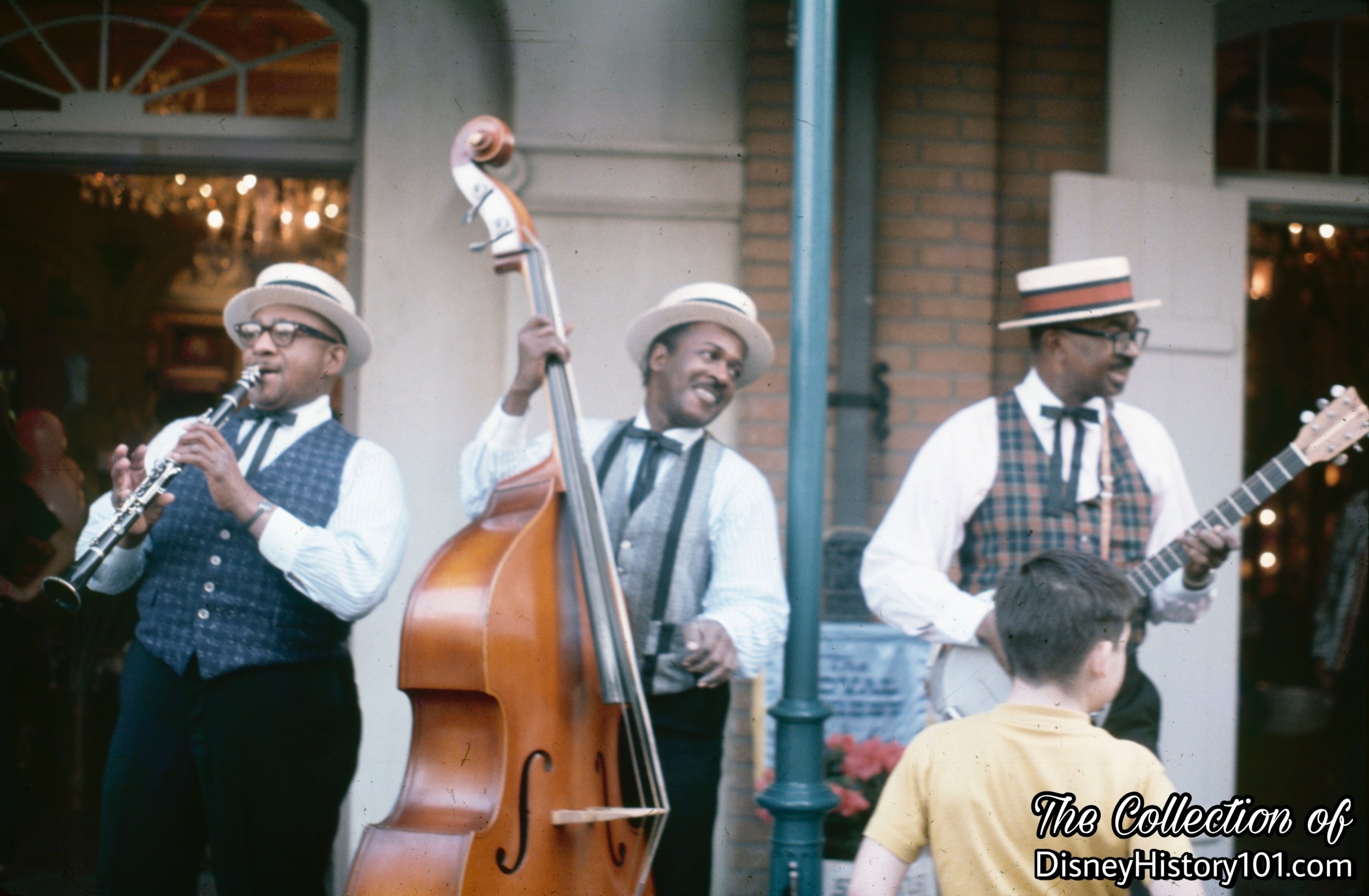
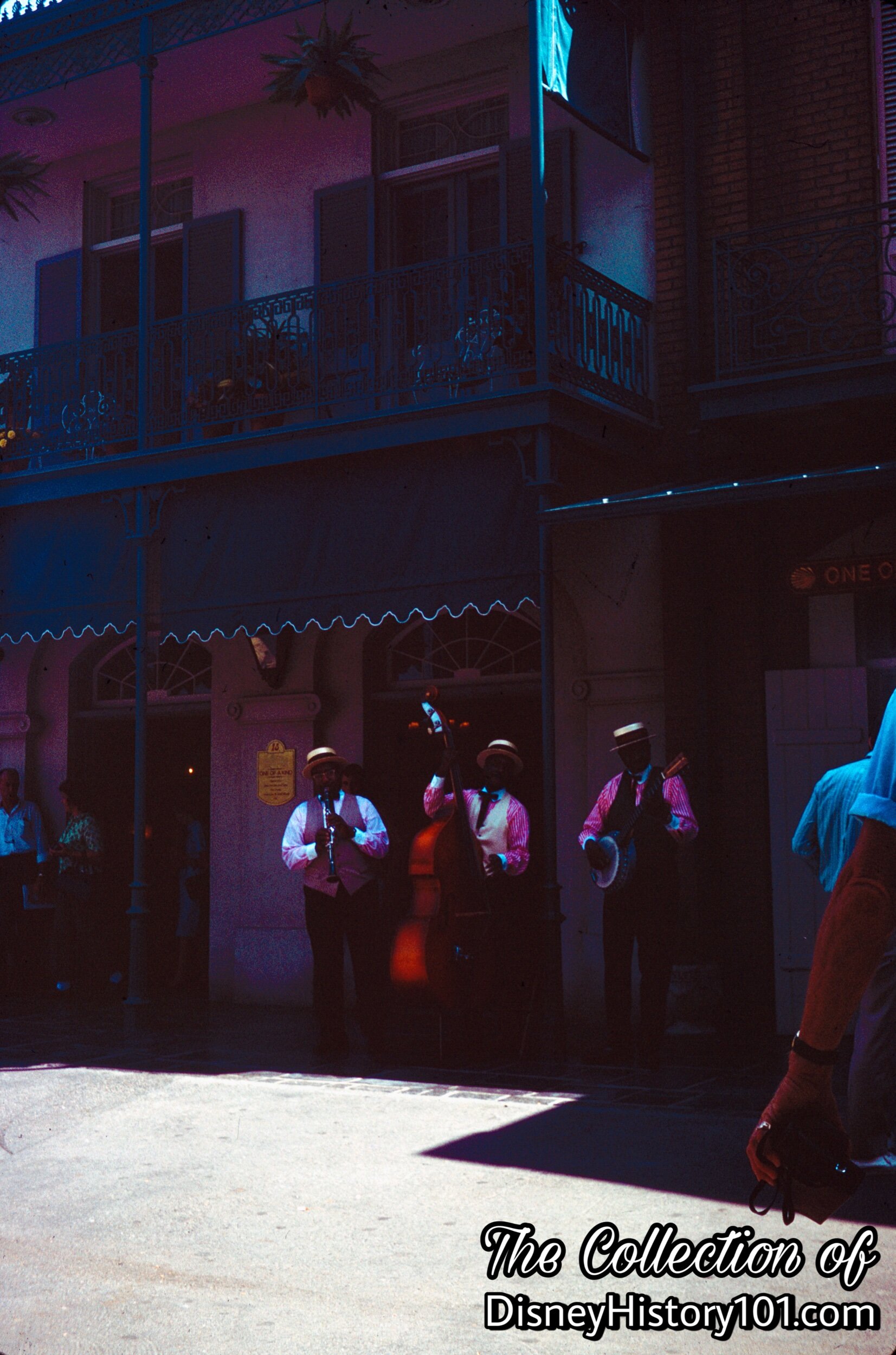
During their early days, the Royal Street Bachelors performed at one of their usual Royal Street locations near the opened Hench doors off the One-of-A-Kind Shop in New Orleans Square. Shows generally occurred throughout the day, from 10:30 a.m. to 5:30 p.m. Billed as the “Royale Street Bachelors,” the trio performed alongside other legendary jazz musicians at the 6th annual Dixieland at Disneyland (held Saturday, October 1st, 8pm to 2am).
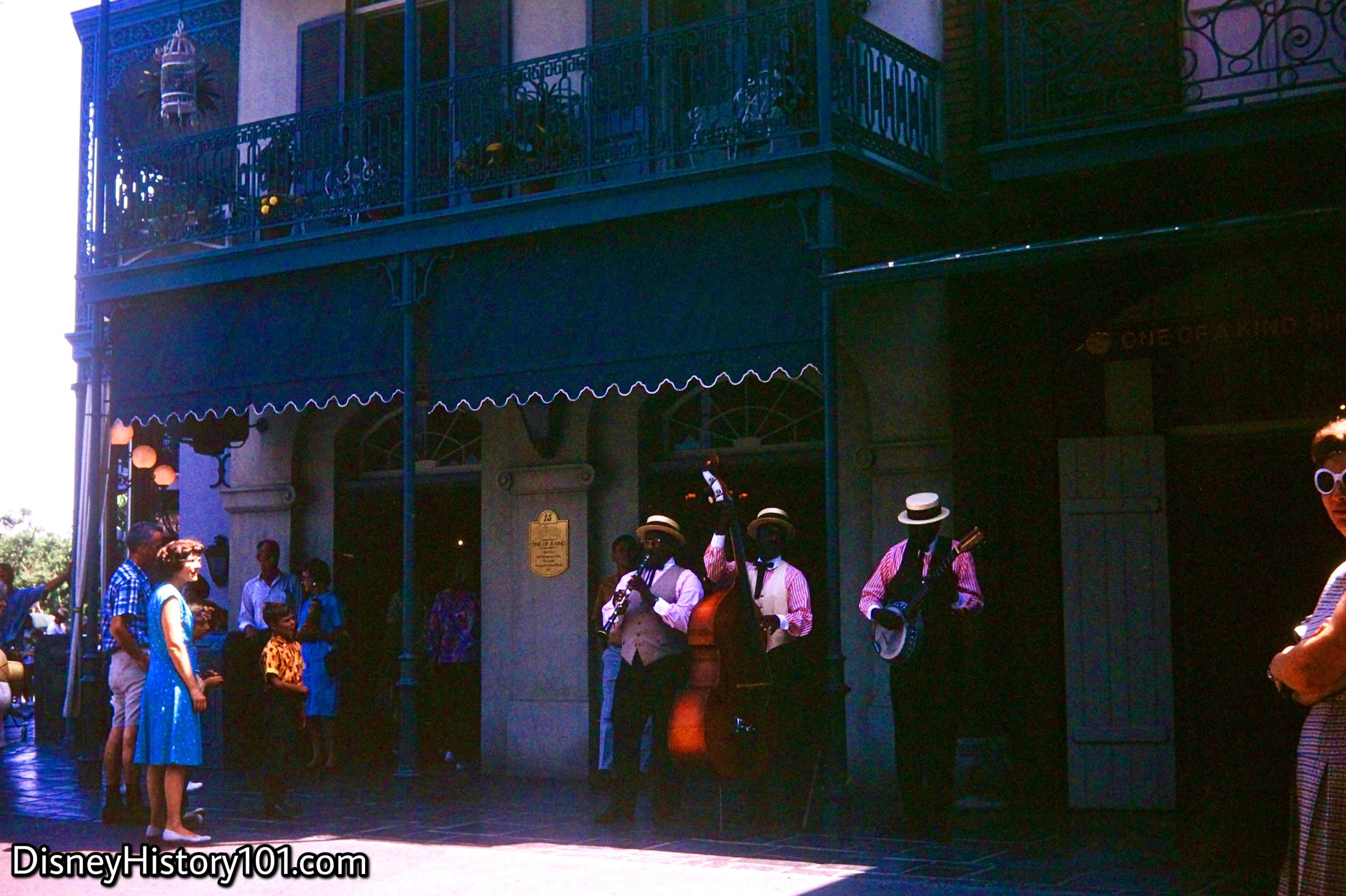
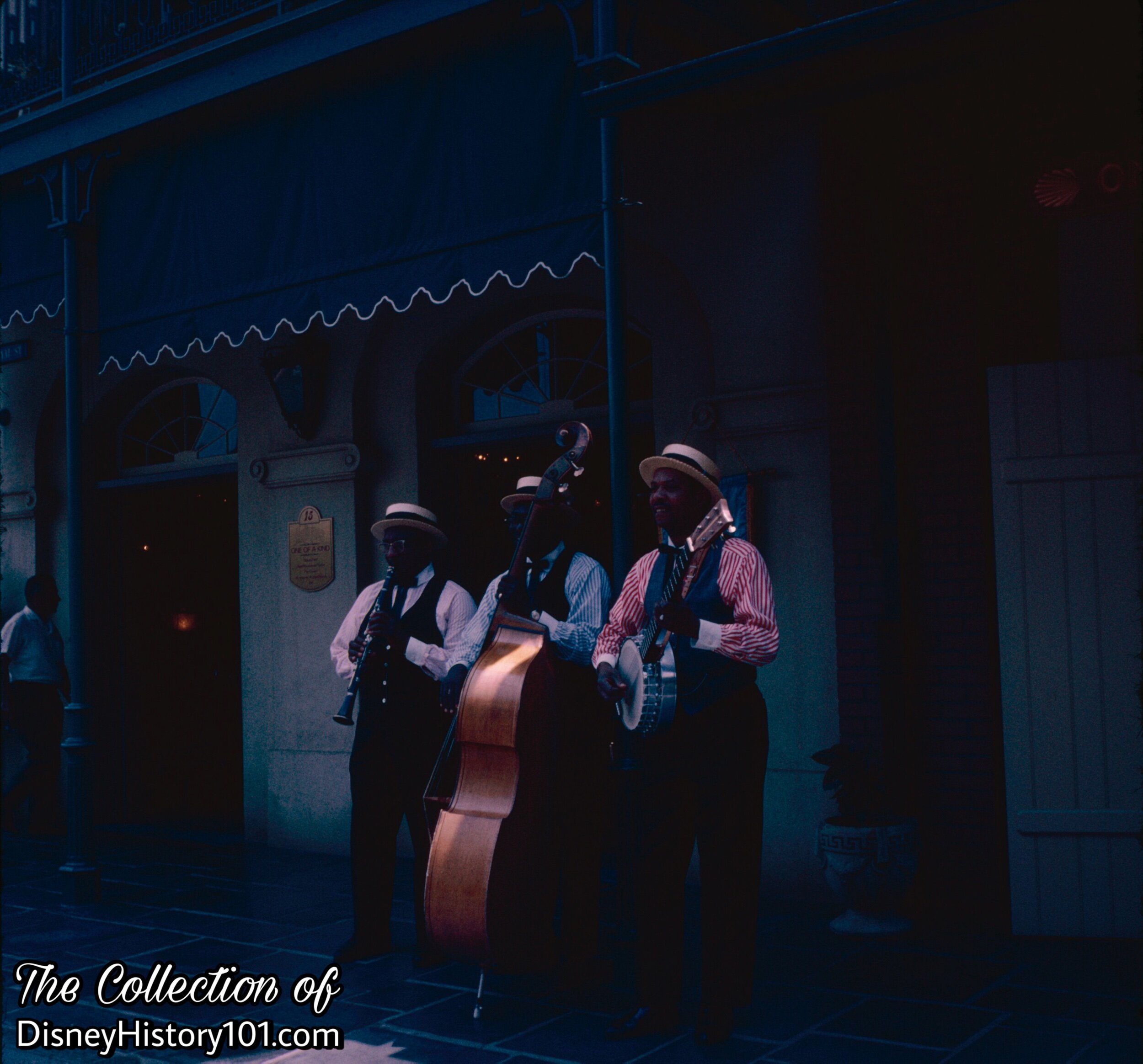
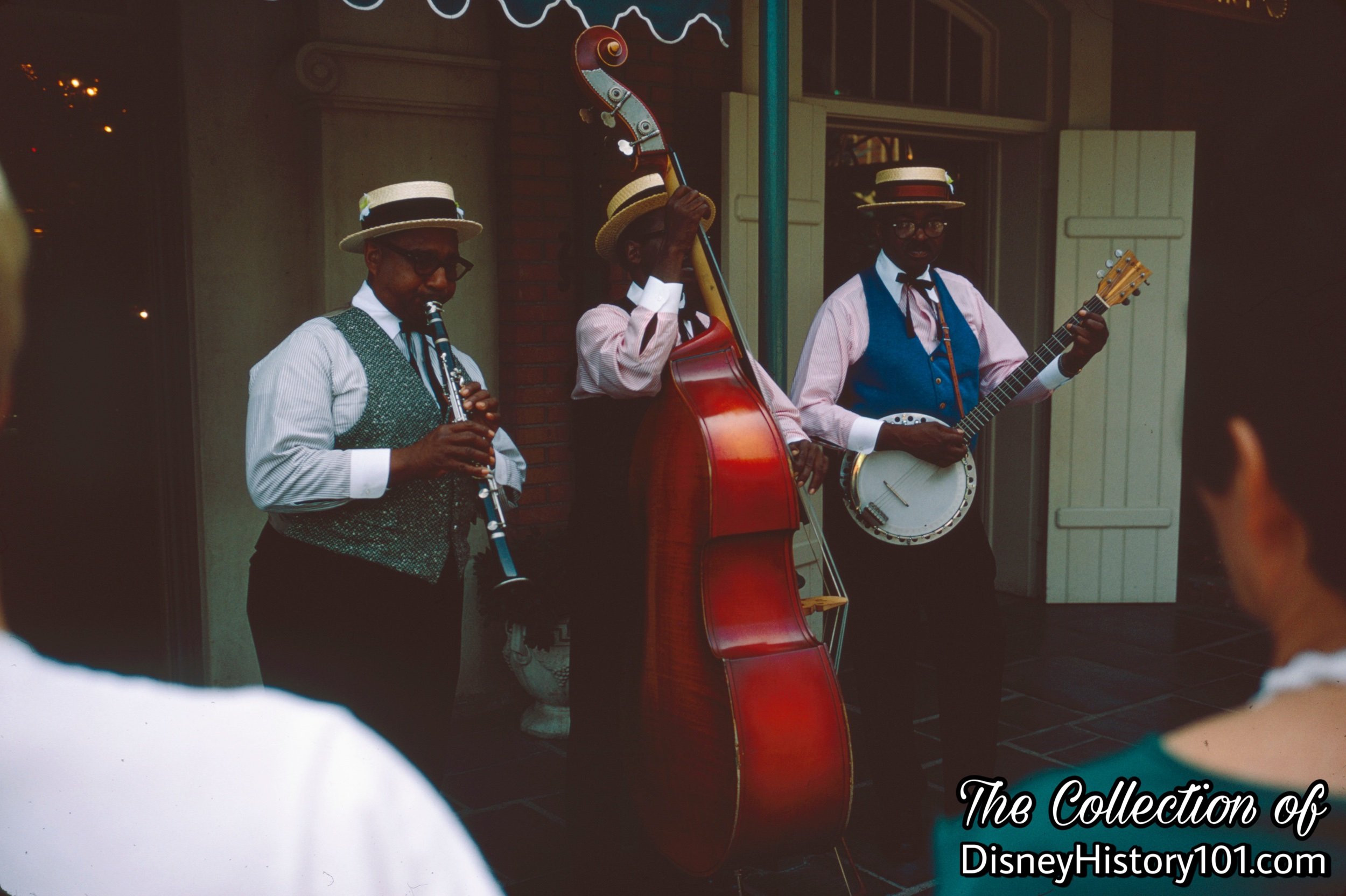
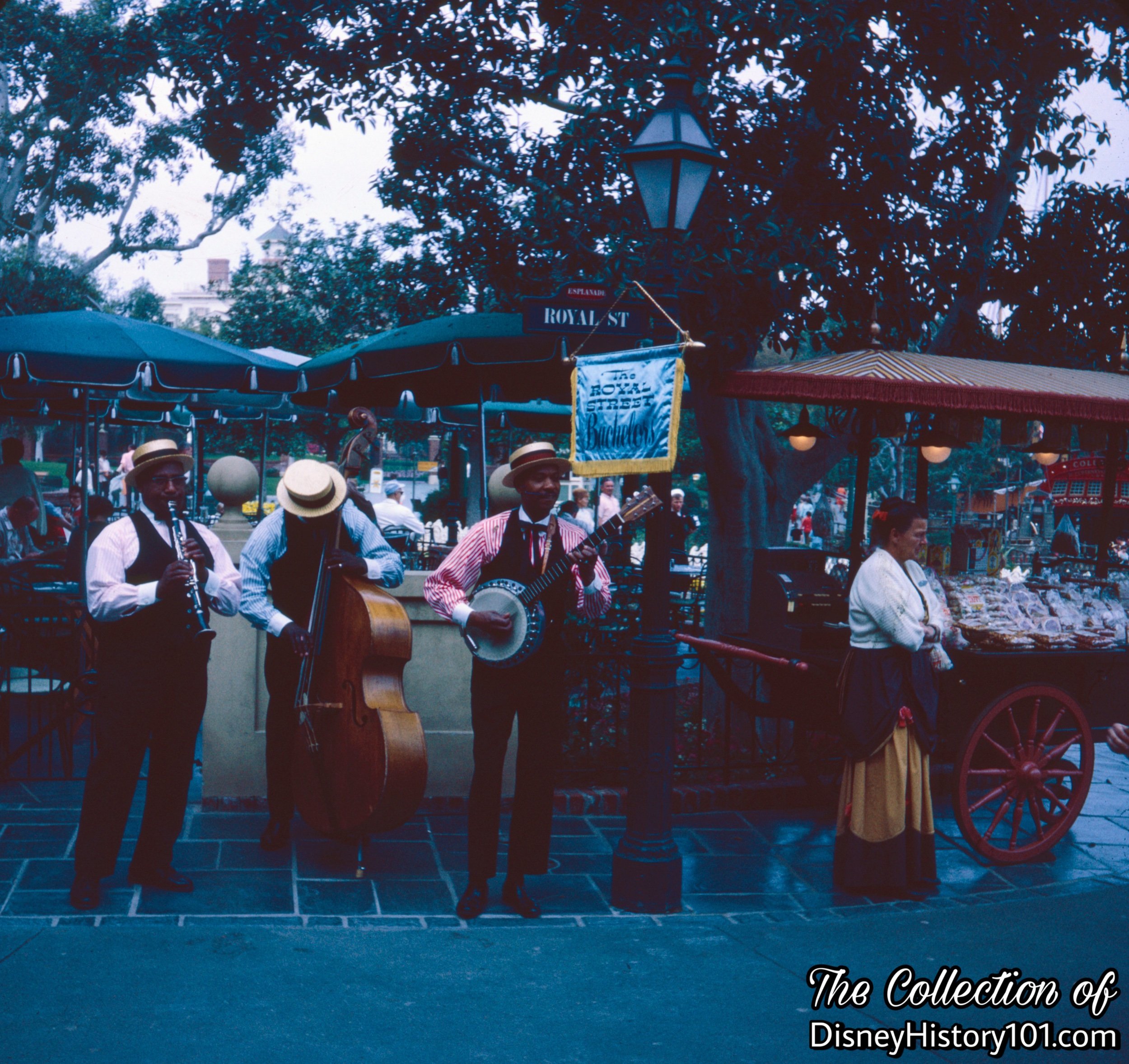

The Royal Street Bachelors occasionally teamed up with another iconic Disneyland act - the Strawhatters. The Strawhatters predated the Royal Street Bachelors by nearly a decade, performing from the Dixieland Gazebo Bandstand along Frontierland’s waterfront thoroughfare originally known as Orleans Street. When New Orleans Square debuted (and the streets were renamed), the Royal Street Bachelors regularly played the One-Of-A-Kind Shop storefront, and the Strawhatters were moved to the French Market Stage. But occasionally the two (now) legendary bands met, and when they did, the result was something special!
Though the Royal Street Bachelors and other New Orleans Square musicians performed in different areas of the land, the “Bachelors” occasionally performed alongside the Shoeshine Boys (Teddy and Kenny) and the Delta Ramblers, as their shifts overlapped.
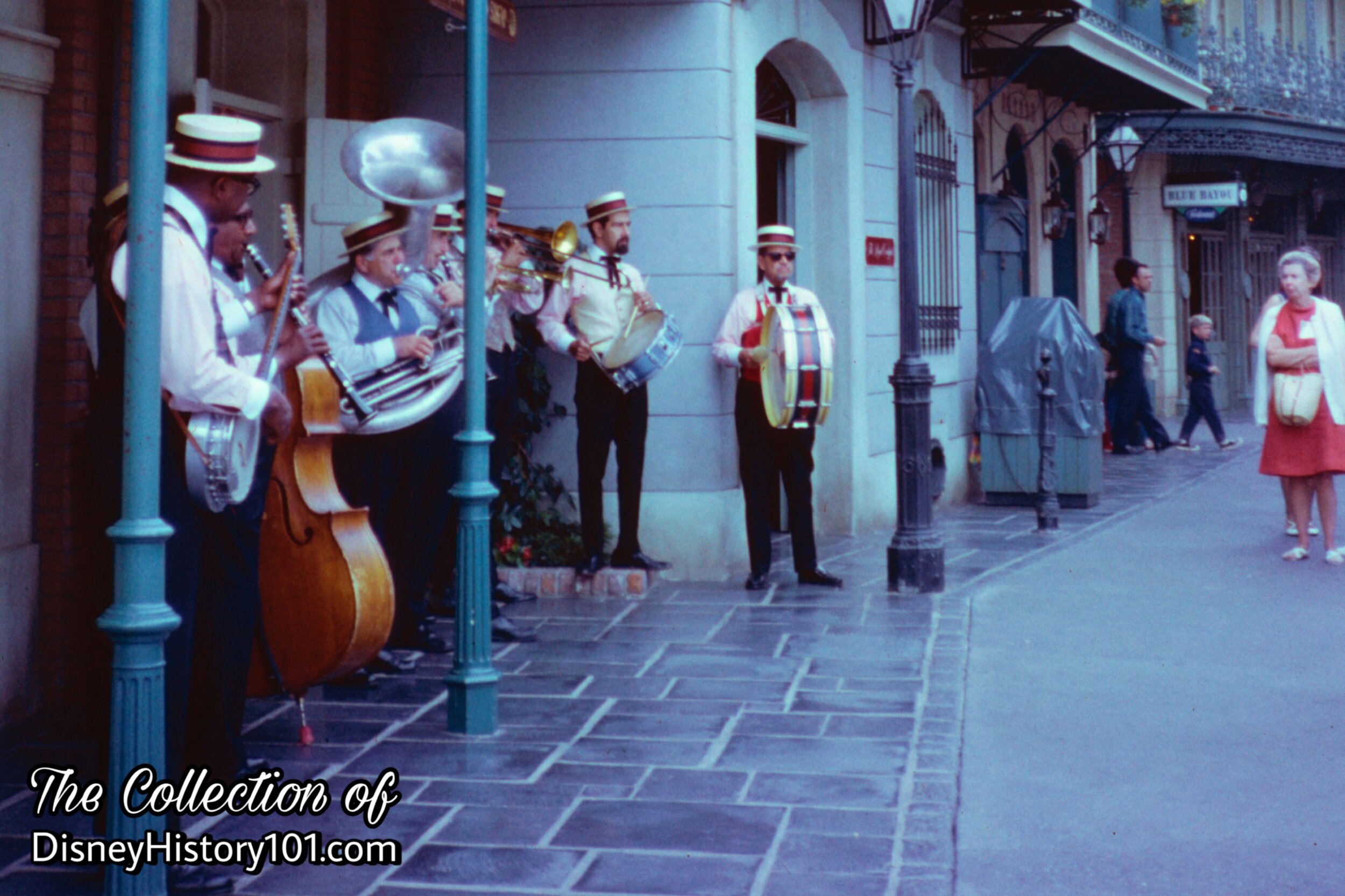

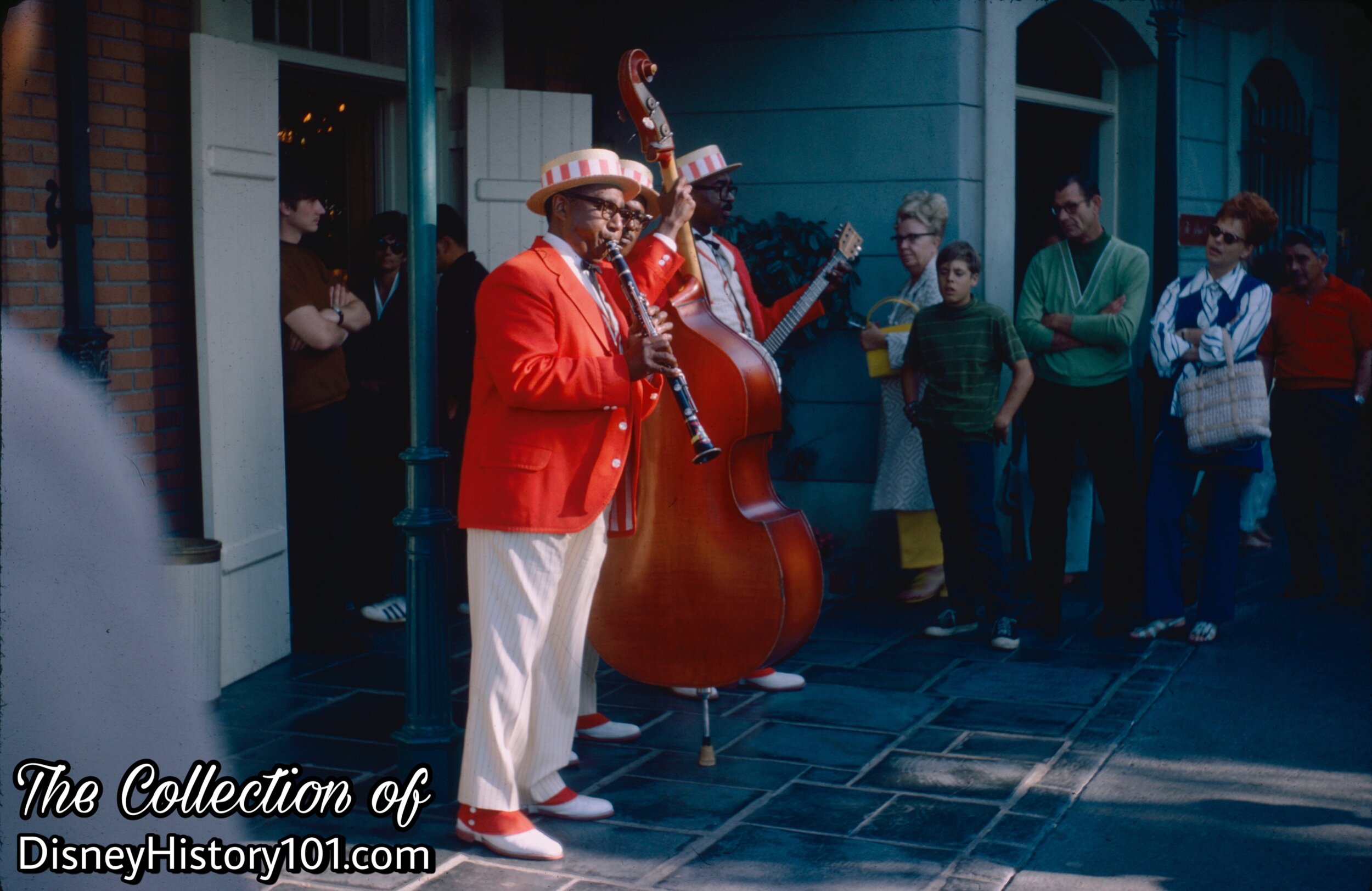
The trio can briefly be seen wearing this very ensemble for their Court of Angels performance of “When The Saints Go Marching In”, while Donnie Osmond, Jay Osmond, Br’er Bear, and Br’er Fox enjoy their melodies and beats, in “Disneyland Showtime” (a c.1970 Wonderful World of Disney episode).
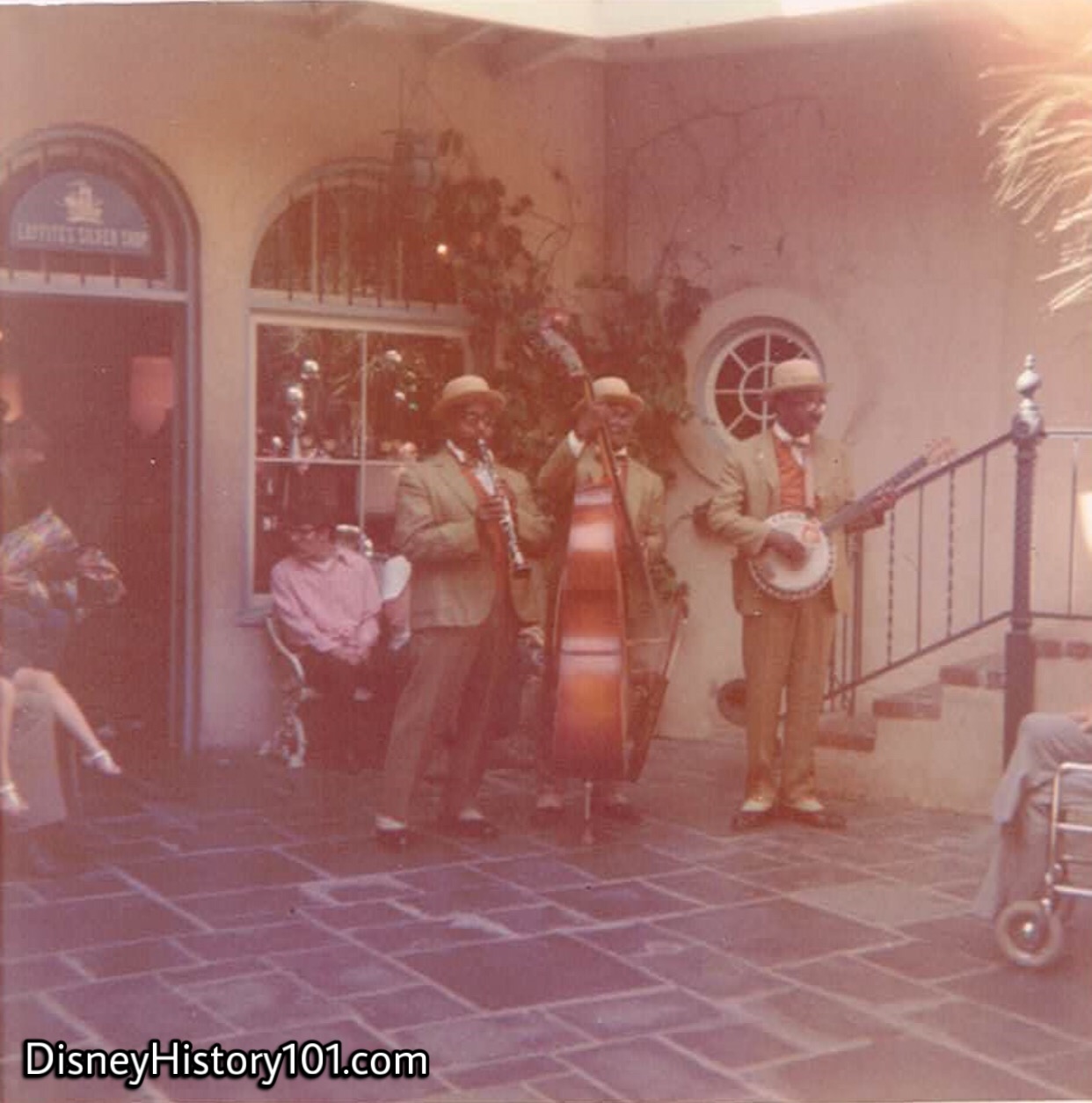
The trio was also known to frequent the little cool alcove near LaFitte’s Silver Shop. Here, they would perform for 30 or 45 minutes. A typical daily schedule looked like this:
11:00 - 11:45
12:00 - 12:45
1:00 - 1:30
2:30 - 3:15
3:45 - 4:15
4:30 - 5:00
5:15 - 5:45
The same year that the preceding “Vintage View” was captured, the Royal Street Bachelors provided evening entertainment for the “Lead-Foreman “End-of-Summer Dinner” (held during the Fall of 1972) for more than 2,000 Park Employees of Disneyland’s Food Division.
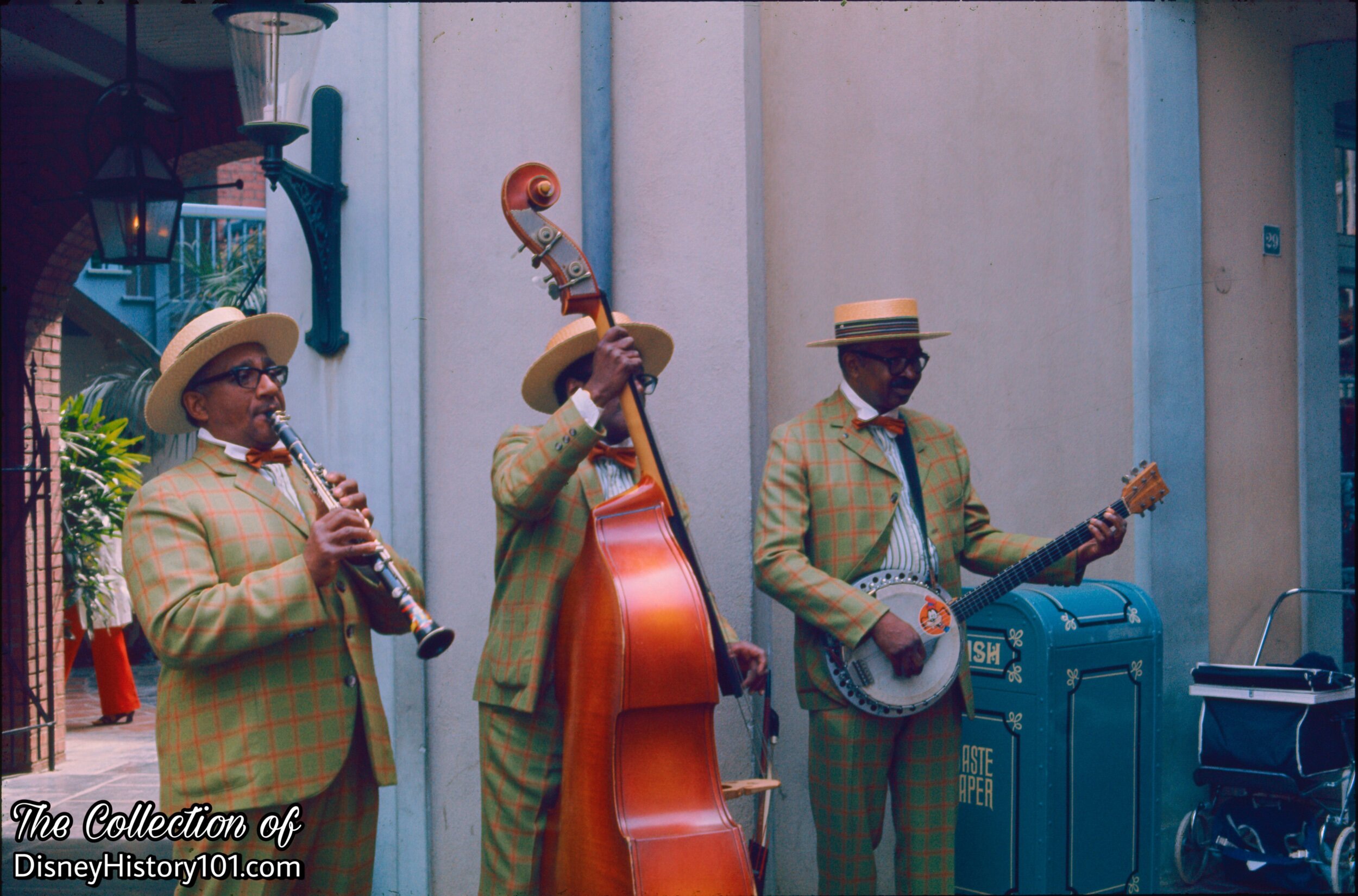
The trio played in the streets of New Orleans Square, nearby Le Gourmet and La Boutique d’Orleans.
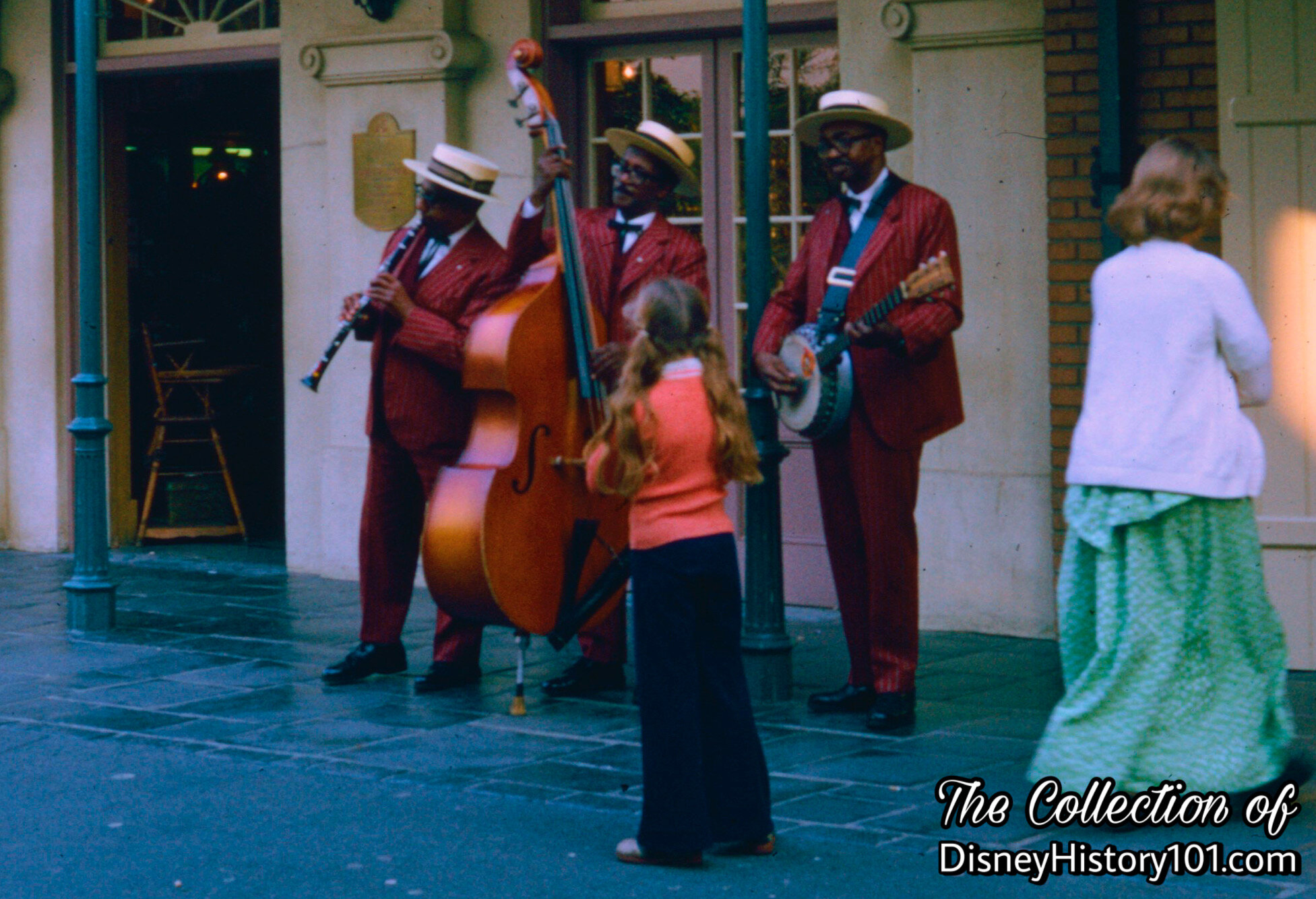
The “one-of-a-kind” trio forms a New Orleans Square “welcoming committee” as they perform in one of their most common locations - the corner of Esplanade and Royal Street, near the One-of-a-Kind Shoppe! During the very year that this Vintage View was captured, Disney News (the official magazine for Magic Kingdom Club Families) told the story of the Royal Street Bachelors in its Spring, 1974 issue.
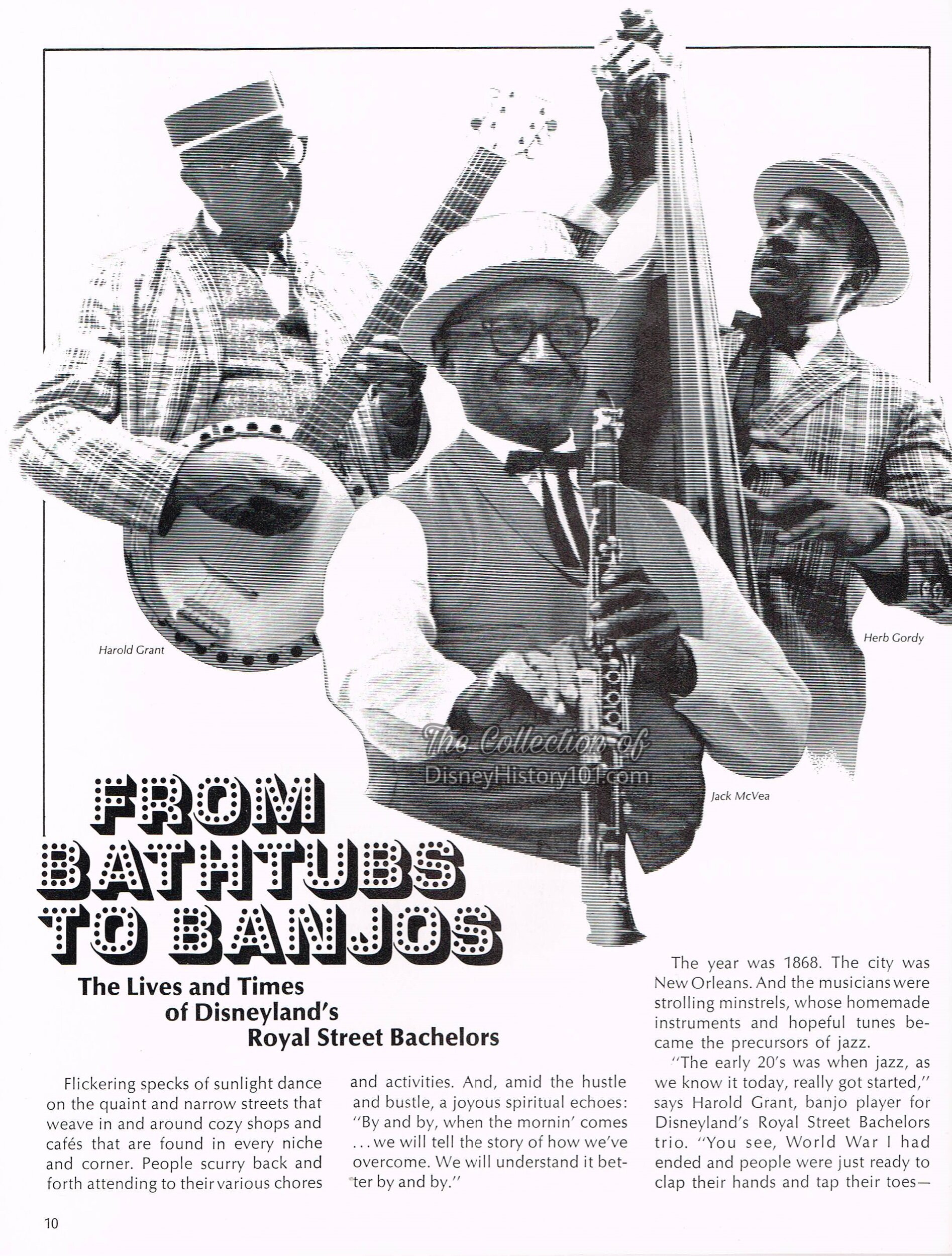
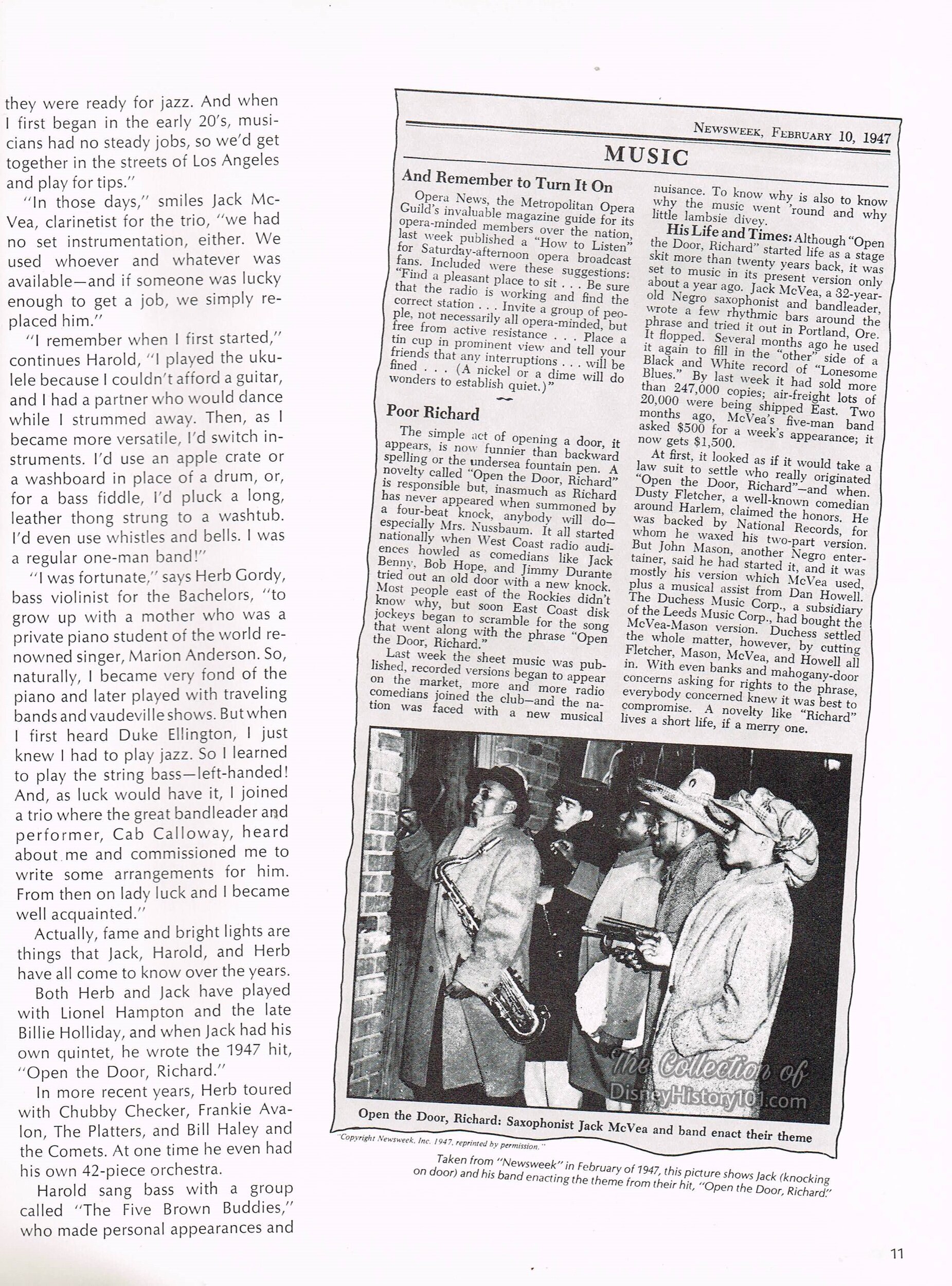
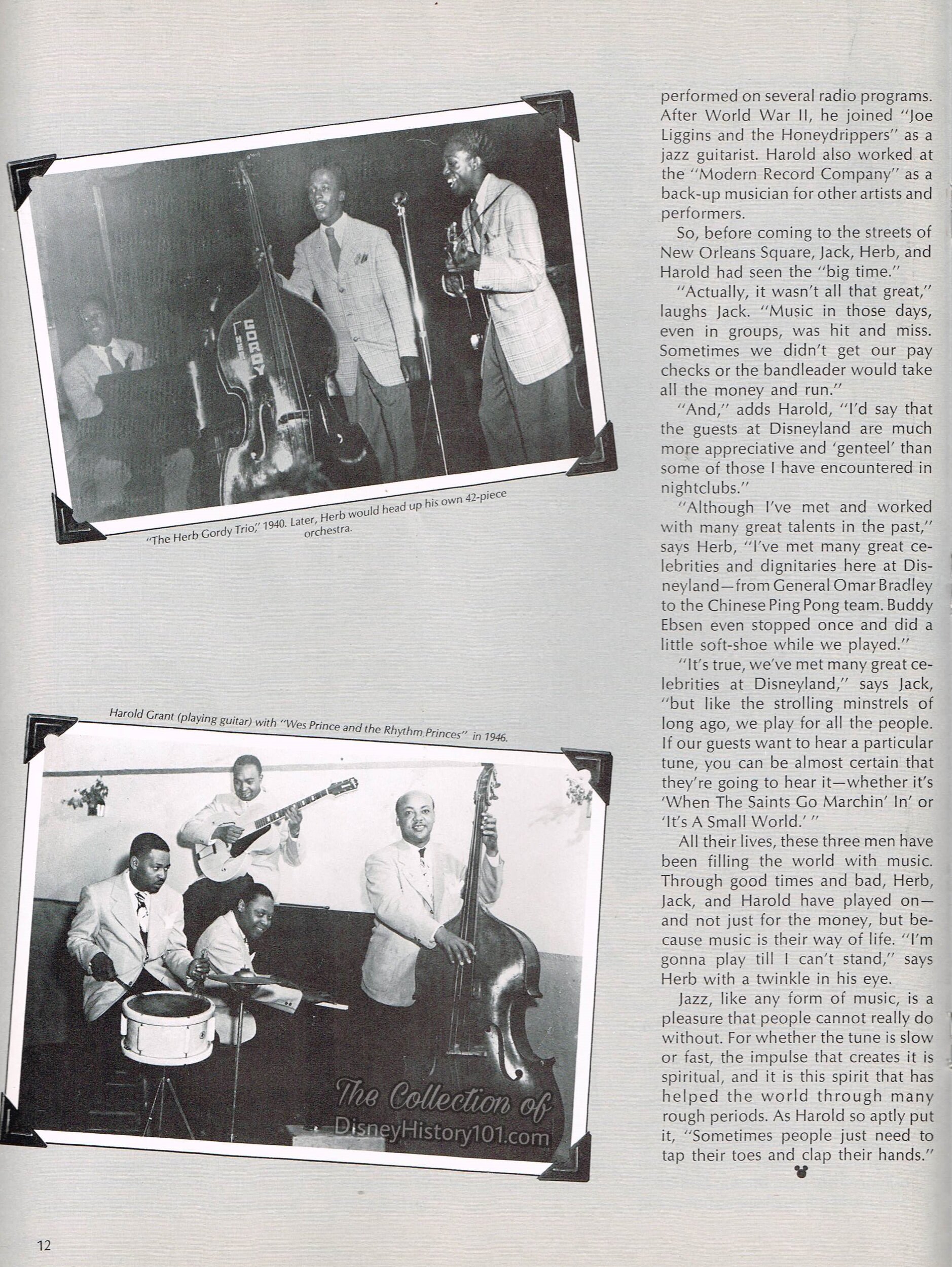
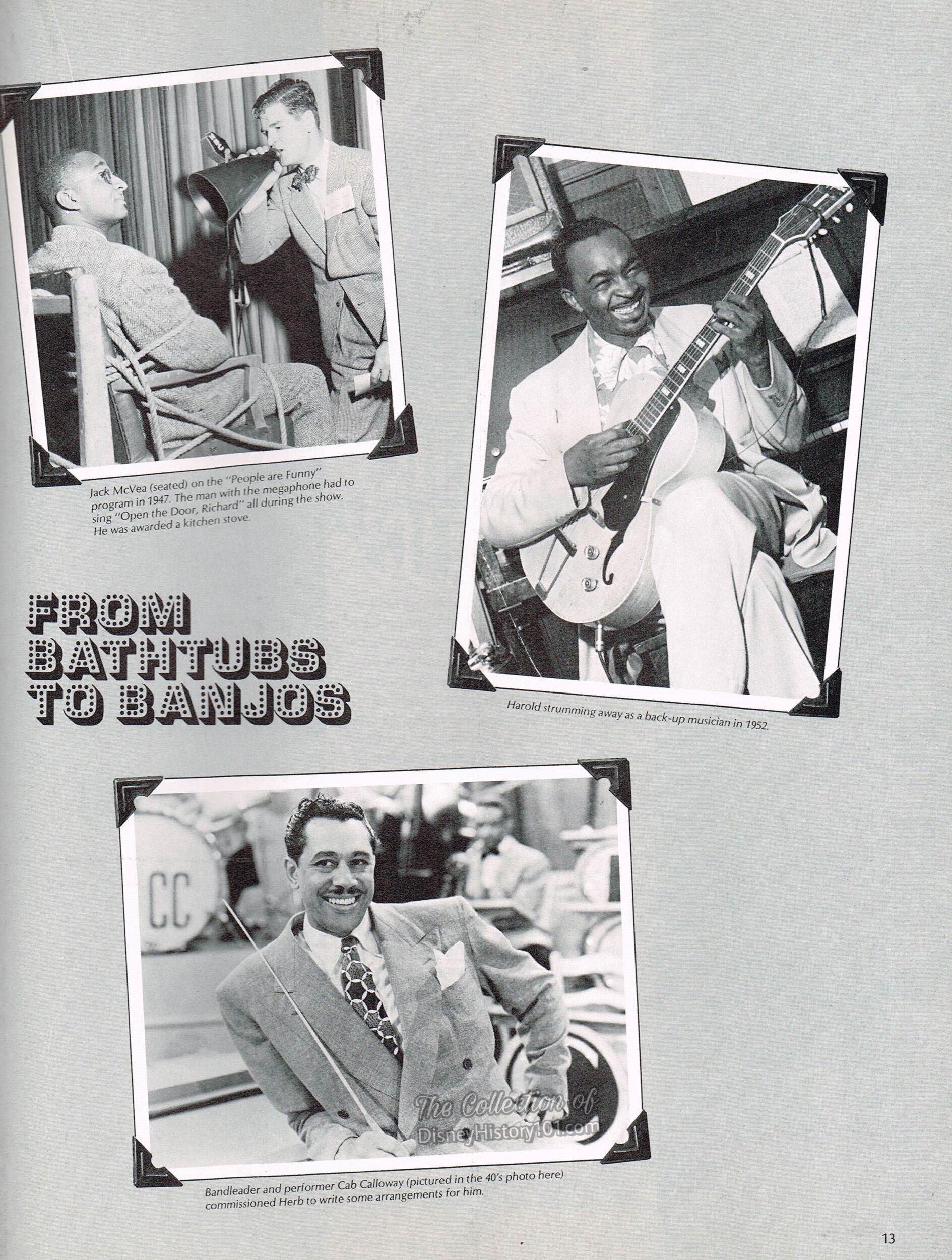
There’s another Disney connection on this page - Herb guest starred on Art Linkletter’s People Are Funny television show. If you’ve ever seen Disneyland’s opening day broadcast, then you know that Art Linkletter has been involved with Disneyland’s most momentous occasions since the beginning!
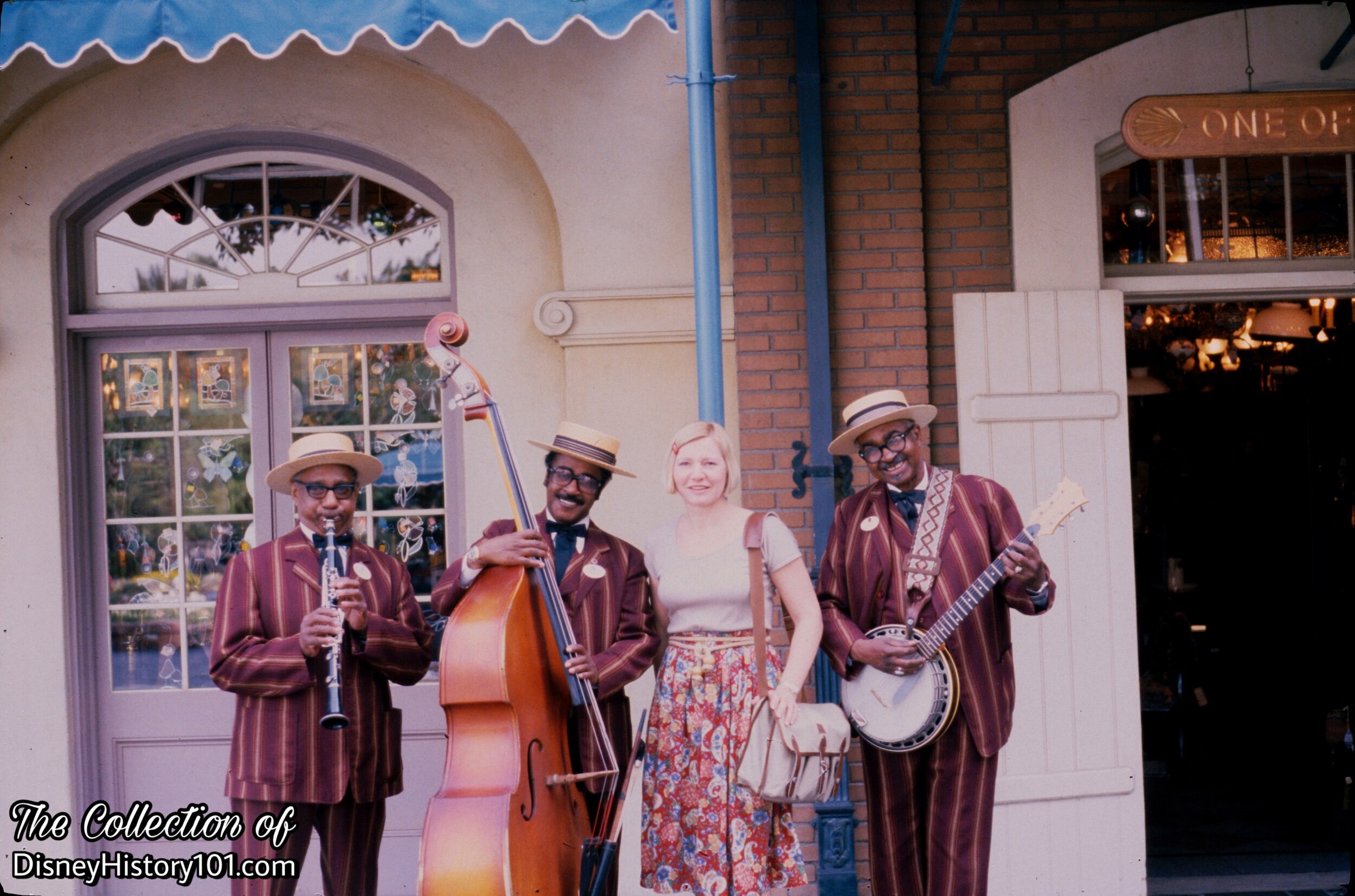
During their later years, the Royal Street Bachelors continued to welcome guests to New Orleans Square near one of their original prime locations, and Disneyland Employee Newsletters occasionally mentioned the members of the Royal Street Bachelors! The band even performed special shows for Disneyland Cast Members only, during the Family Open House of 1980.
Disneyland LINE (vol. 15, no. 25), published June 23, 1983, gave honorable mention to Jack McVea (17 years), Herb Gordy (16 years), and Harold Grant (15 years) - veteran Cast Members who possessed a “world famous Disneyland smile” that was “guaranteed to shine throughout the Park all summer long”! The accolades had not ceased three years later, when Disneyland LINE (vol.18, no. 6) of February 6th, 1986, highlighted Jack McVea’s contributions in the column “It Takes People”. The Royal Street Bachelors continued to be featured in Park media, for instance, they can be seen performing for a brief few seconds, on the c.1993-1994 VHS format “A Disneyland Day - Relive The Memories” souvenir.

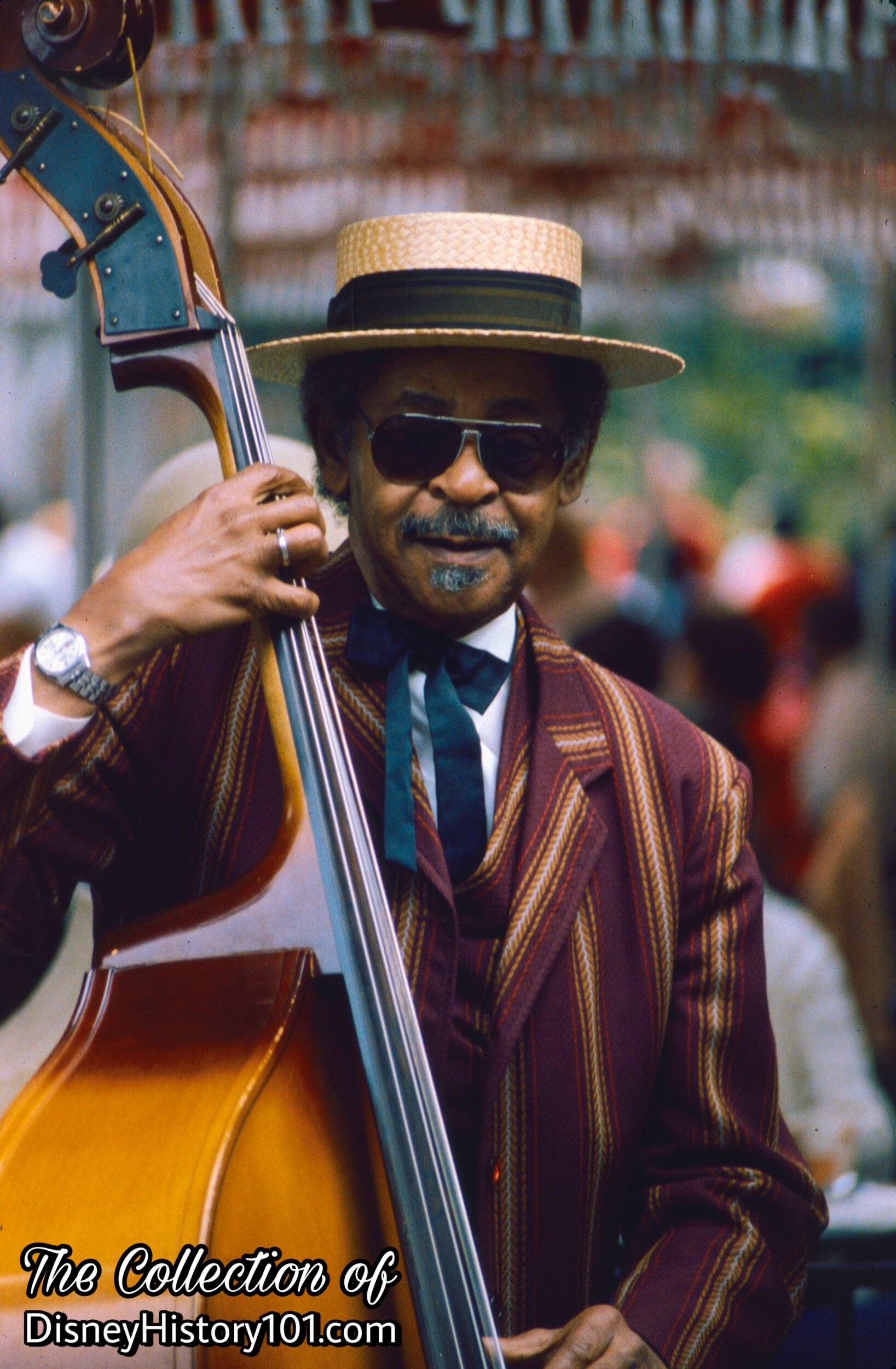
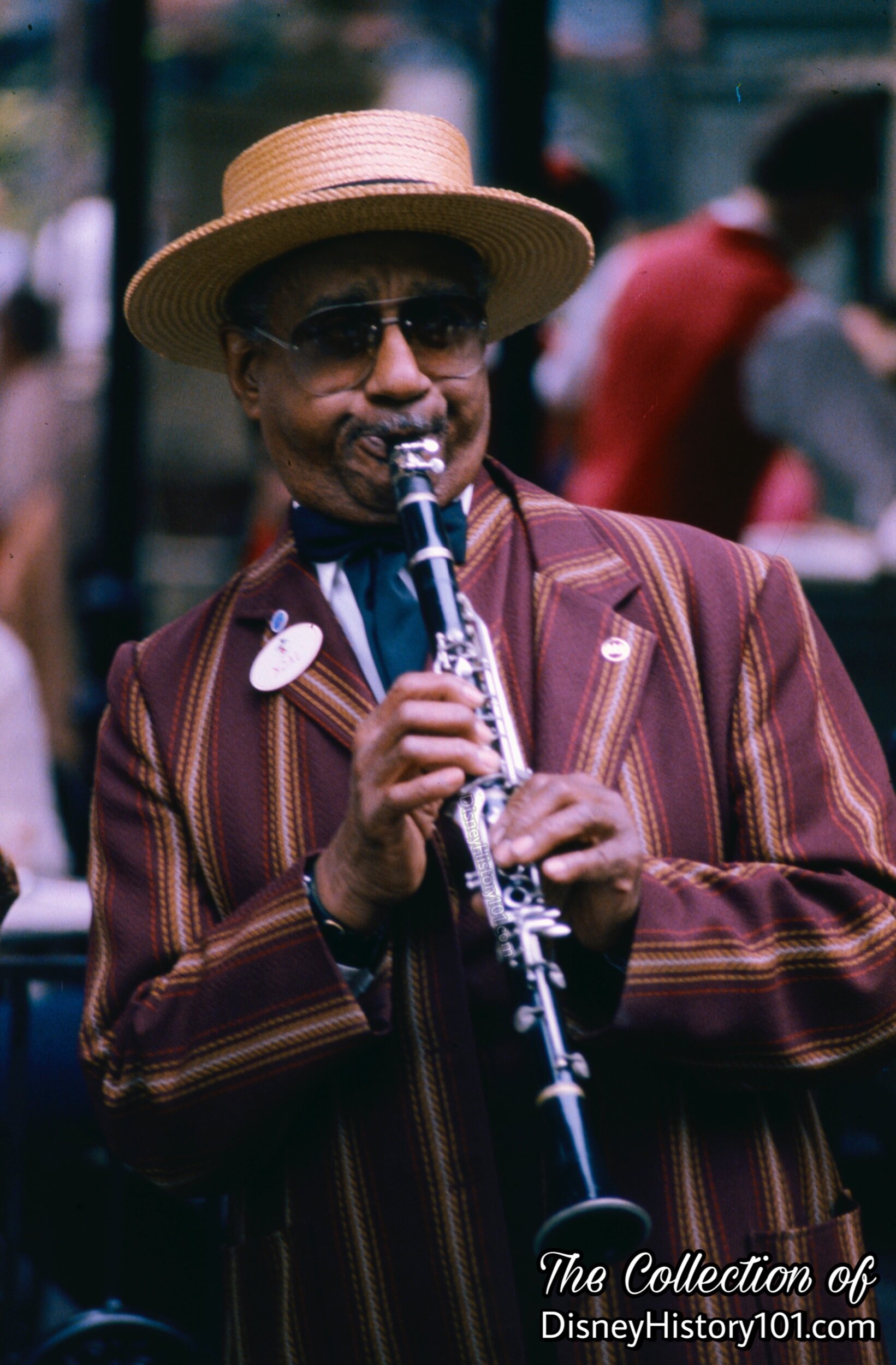
By 1986, the Royal Street Bachelors were performing between 10:30 a.m. and 5:15 p.m., Wednesday through Friday.
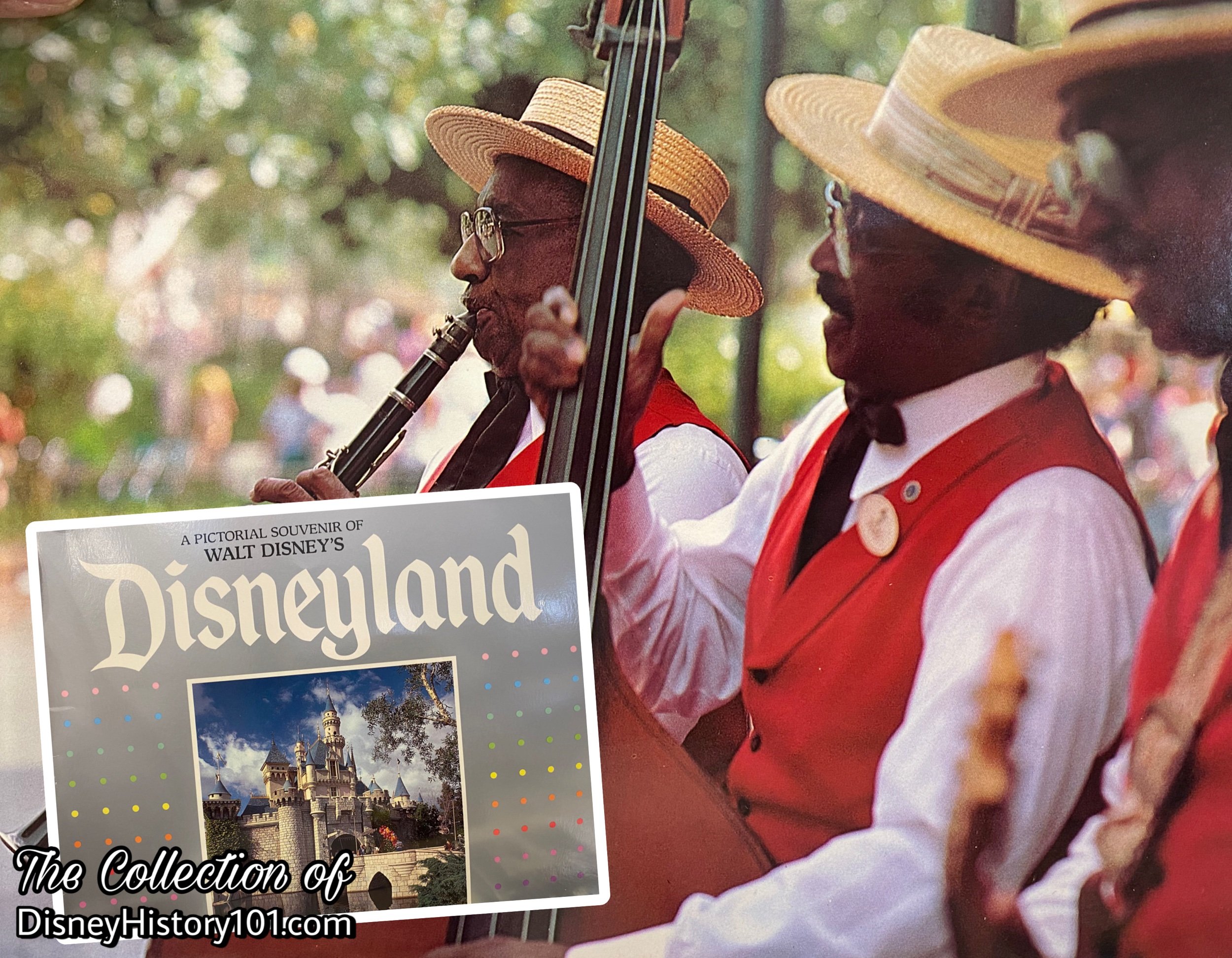
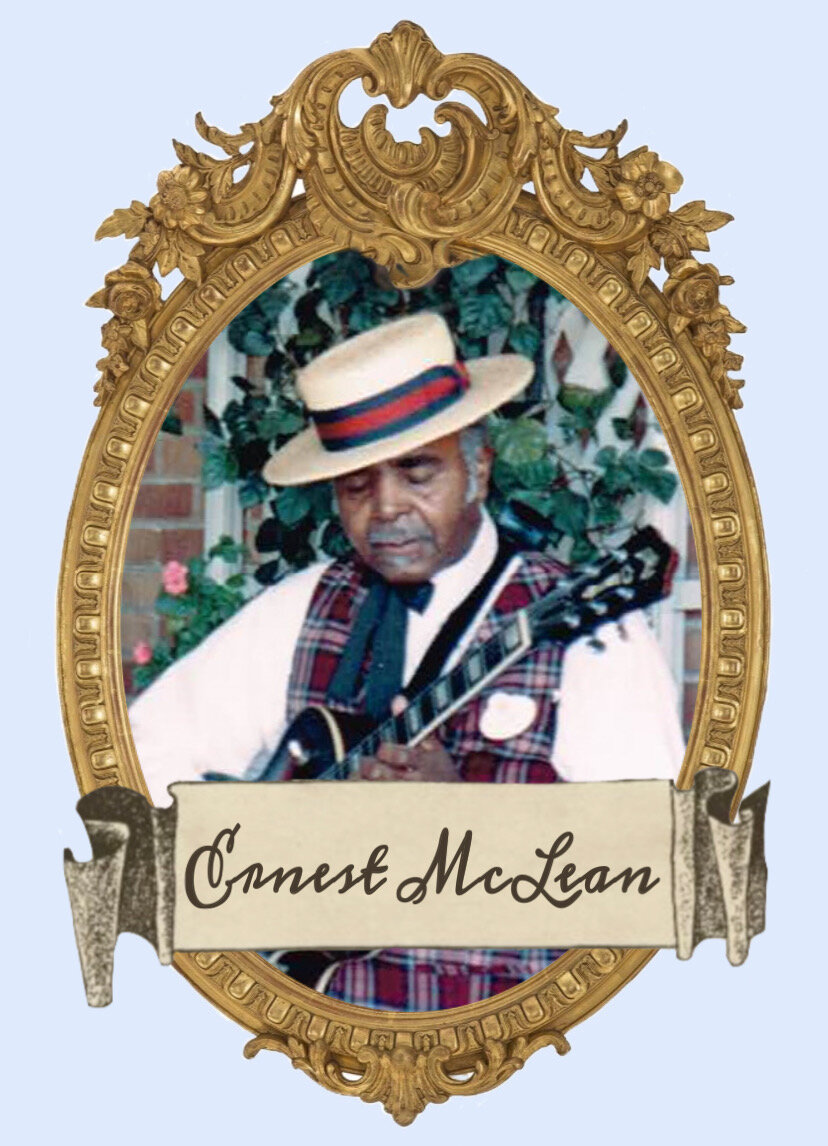
Ernest (a.k.a. “Ernie”) McLean would later substitute for Harold Grant (on banjo). In an excerpt of a Disney Parks interview (which can be read at the DisneyParks Blog HERE). Ernest recalled how he was personally called by Walt Disney, to be a part of the Royal Street Bachelors in Disneyland : “I auditioned as a guitar player for a tour. I didn’t think I was going to get the job. Then they started to talk about rehearsals and going to the studio, so I stopped them and said, ‘You haven’t offered me the job,’ and they replied, ‘Why do you think we are telling you this if you didn’t get the job?’ Once the tour ended, [Walt] Disney eventually called me to sub for the banjo player at Disneyland. That is when I became permanent at Disneyland.” When he wasn’t playing a solo (near a hidden amplifier) in one of New Orleans Square’s quiet alleys, Ernie was a Royal Street Bachelors regular on guitar and banjo. This he did for more than 30 years.
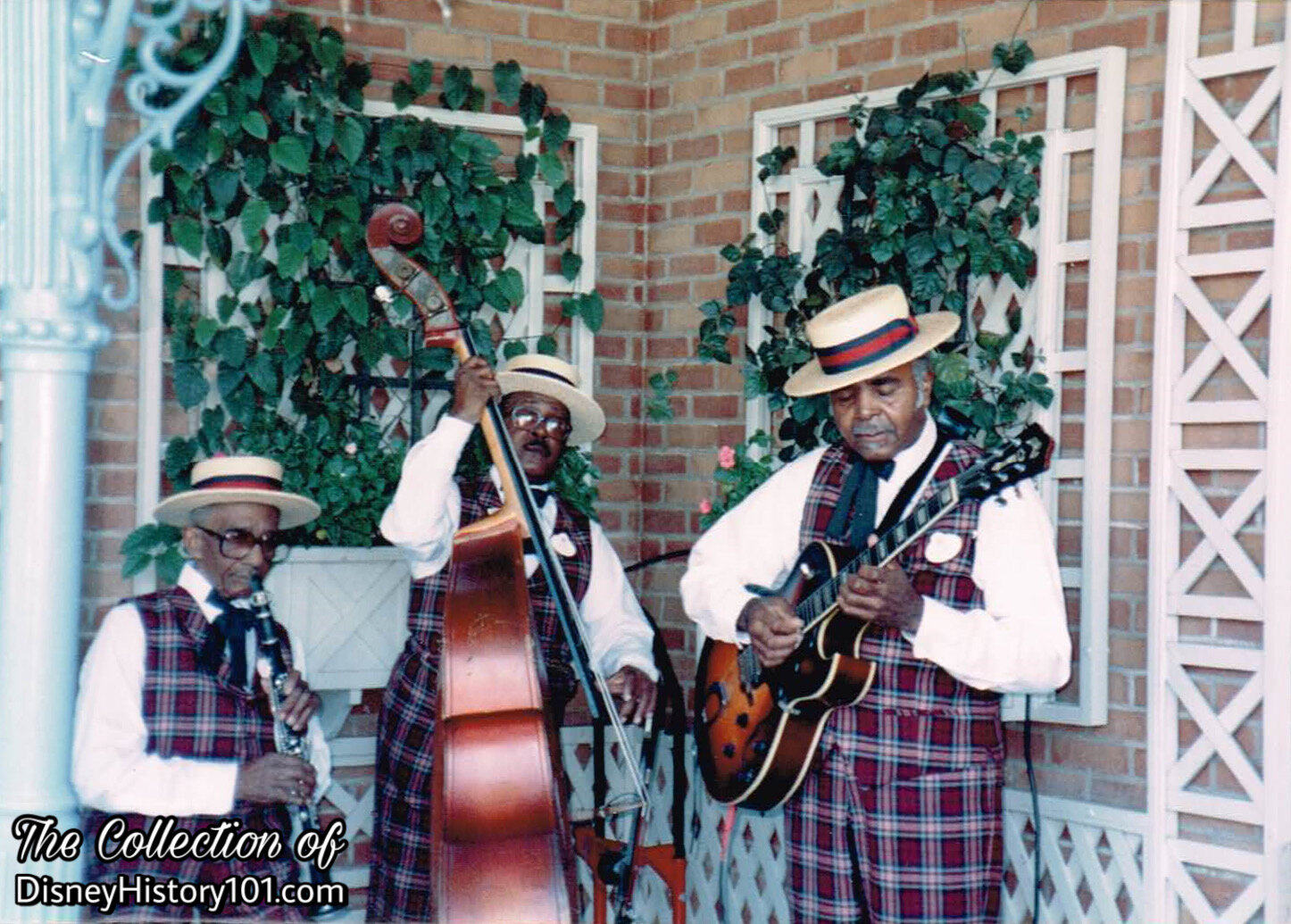
Two years after this Vintage View was captured, Jack would retire from Disneyland.
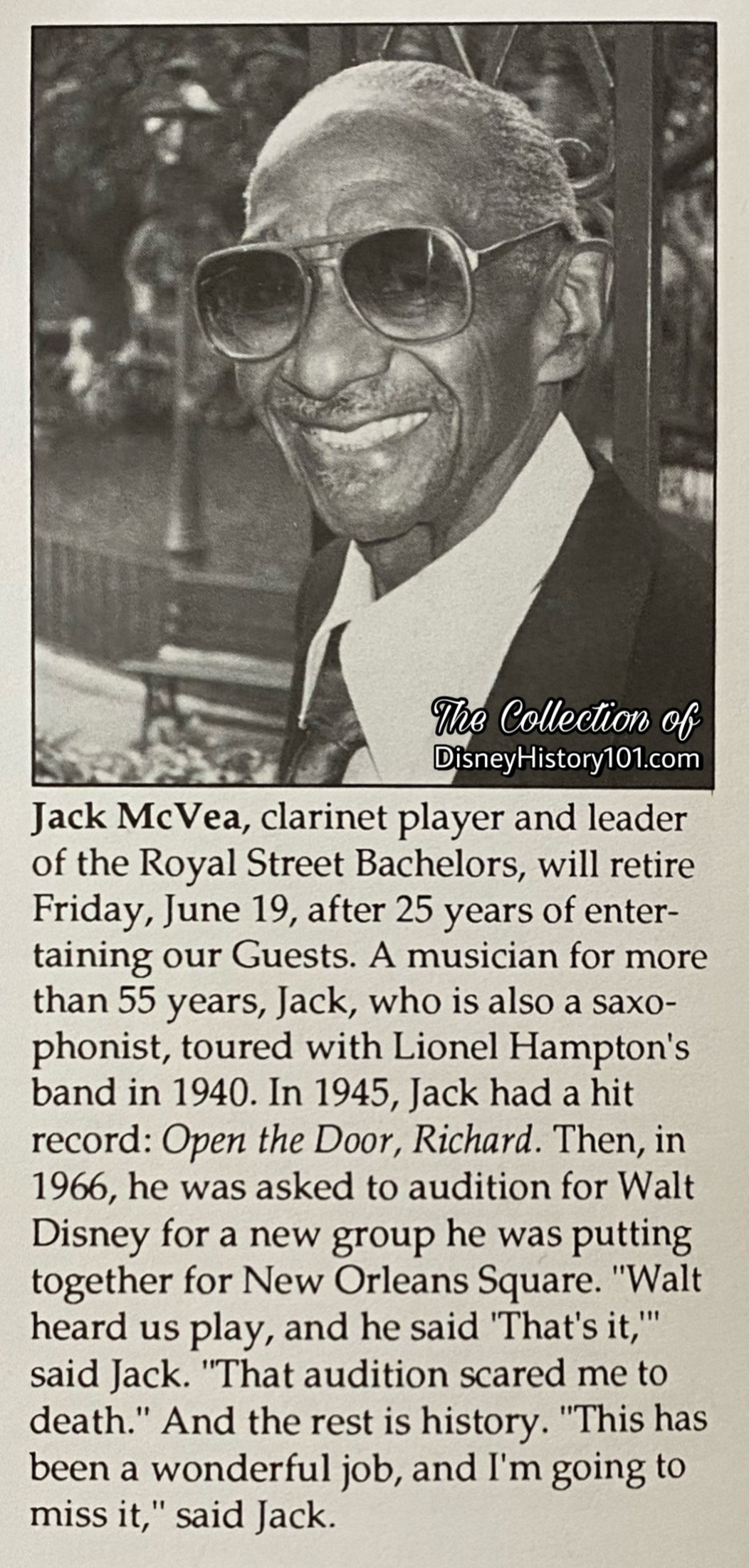
Yes, Jack McVea led his original Disneyland band - the Royal Street Bachelors - for a total of twenty-six years - from 1966, until his retirement in 1992! During that time, Jack encouraged the principles involved in a process that Walt called “Performance Excellence.” He encouraged the members of the Royal Street Bachelors to strive to excel each day in the fulfillment of their individual roles and responsibilities in an environment consistent with defined Disney behaviors. As a result, the Royal Street Bachelors were continually challenging themselves and each other to try new methods of working more effectively and efficiently. This was evident through their harmonious teamwork as they accomplishing these efforts.
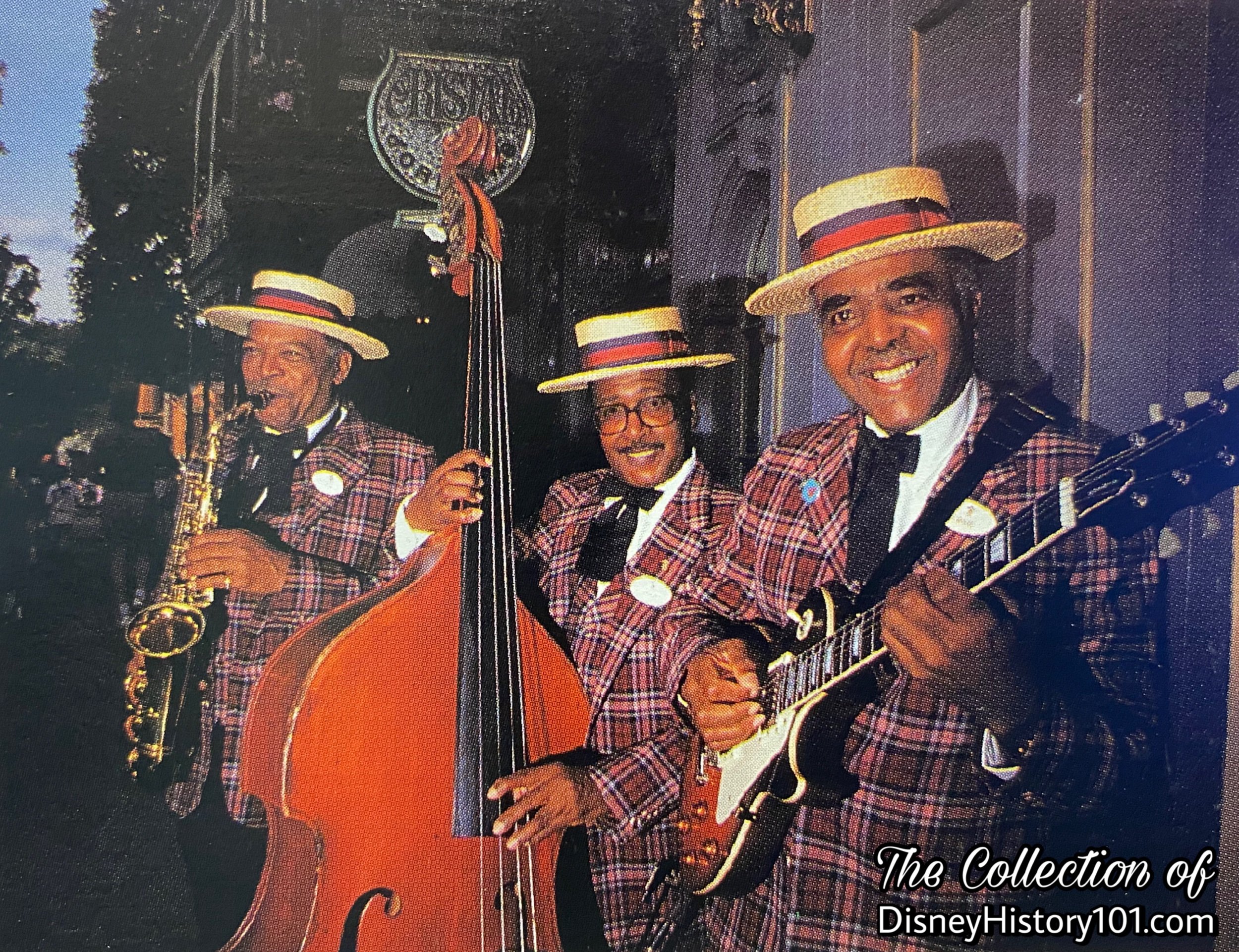


Unlike other successive bands which would appear on Disneyland’s “stage,” this trio would become immortalized as both a New Orleans Square icon and tradition (well beyond their lifetime). Their images can be seen in numerous pieces of promotional printed items (like Disneyland Souvenir Guides, and advertisements). The measure of the Royal Street Bachelors’ contributions, can be seen, felt, and heard, in the rich and living legacy which they have left behind. The presence of the Royal Street Bachelors is still certainly felt in New Orleans Square!
Though the present Royal Street Bachelors band consists of more than three members (on stage at one time), it carries on the spirit of the original band, by channeling some of the same Dixieland melodies that the original trio played. Members over the years have included Kenny Treseder (saxophone), Terry Evens (guitar), Jefferey Littleton (bass), and many others. Instead of performing in various locations along Royal Street, the Royal Street Bachelors now generally perform from the French Market Restaurant Stage. The present showtimes occur occasionally in the morning, around noon, and generally hourly after that, until around 5p.m.

During 1991, Imagineer John Horny immortalized “The Royal Street Bachelors” in a painting that would be released as a limited lithographic print thru The Disney Gallery. One of the prints hung in the original foyer stairway of Club 33 at Disneyland for a number of years. An associated plaque read : “John Horny captures the true spirit of ‘the birthplace of jazz’ in his painting of the Royal Street Bachelors - Jack, Herb, and Ernest performing in New Orleans Square as they have since the land debuted in 1966.” The homage likely had the approval of the current members, who autographed an original print (which was auctioned through Van Eaton Galleries many years later). A print currently resides in the foyer of Disneyland’s redesigned Club 33.
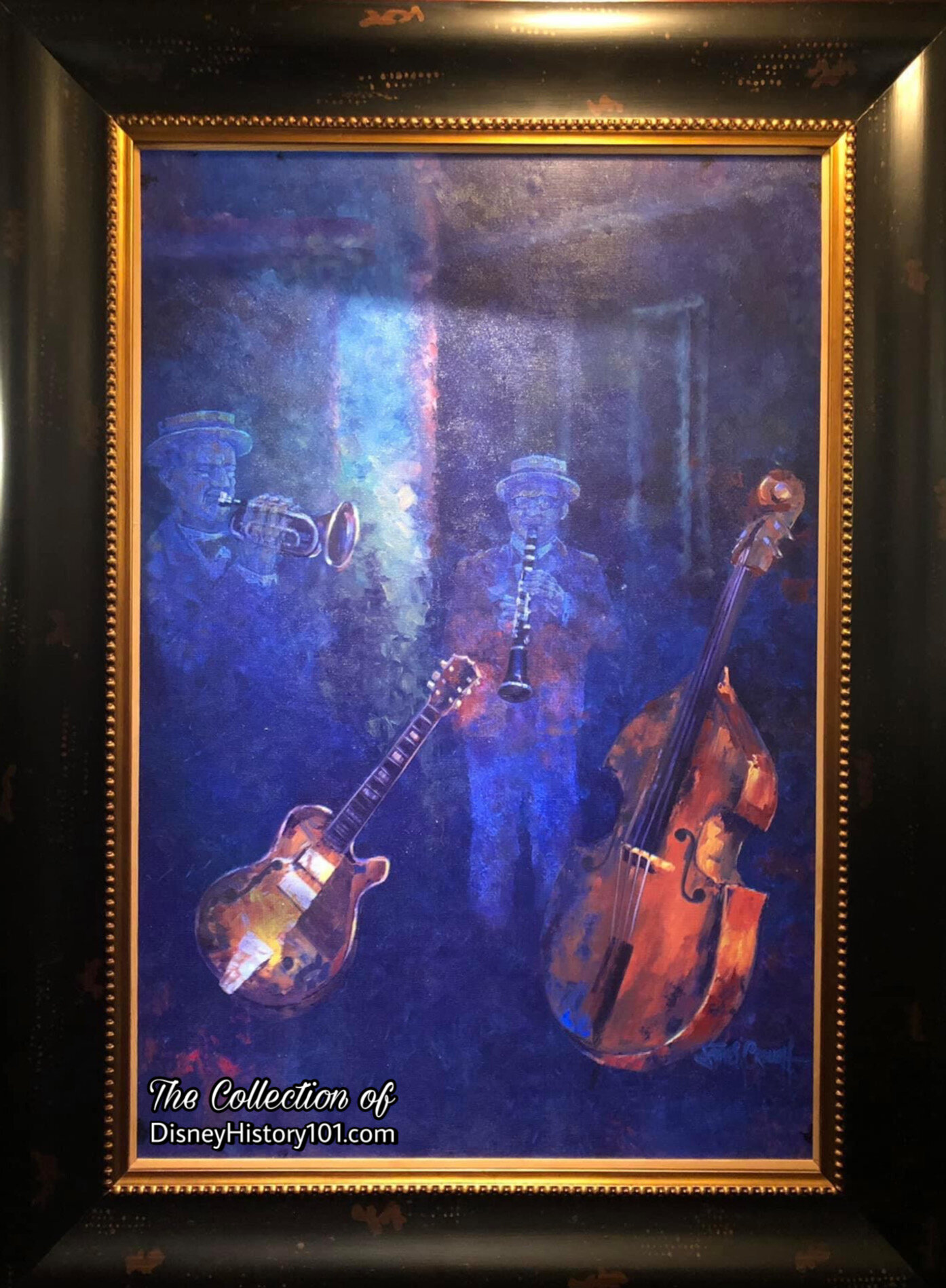
The Royal Street Bachelors also inspired another iconic New Orleans Square attraction which is unseen by most Disneyland guests (but must be seen to be believed) - an animated painting, which hangs in the Members-Only Lounge of the new Club 33! At intervals, members of the trio (plus one Strawhatters member) will “disappear” to “play” a solo or a duet. The wall mounted instrument animates and seems to play by itself. Once silenced, the Royal Street Bachelors member reappears yet again in the painting. Designers of this Club 33 Members Only Lounge went to great lengths to make sure that the feel and tone of the accompanying music honor the memory of the original Royal Street Bachelors!
SPACE BAR

Get ready to “dine at Disneyland” like never before - enjoying “Tomorrow’s food service today!” A long time ago…before General Electric’s Carousel of Progress…before Innoventions…and (definitely) long before Star Wars Launch Bay…was Tomorrowland’s “Stratosnak” Space Bar!

According to “THE DISNEY THEME SHOW - an introduction to the art of Disney outdoor entertainment: Volume II”: Of all the guests’ senses that come into play at Disneyland, the most difficult response to predict was taste. If 70,000 guests were to arrive on a single day, there would probably be 70,000 different ideas about food. Generally speaking, Disneyland food locations fall into three categories - sit-down restaurant service, “buffeteria,” and fast-food categories. The most extensive theming has always been found in the sit-down restaurant locations but all locations were housed in authentically motified facilities.
The Space Bar was to be the first West Coast version of the automat (a common type of dining experience in New York during the 50s and 60s), with a catch - guests would dine in the futuristic year of 1986. Both Herb Ryman and Gabriel Scognamillo created many concepts (rough layouts, elevations, and artistic drawings) which contributed to the final design of the “futuristic” automat. [Some of these designs were refined and published later on July 15, 1955, as a supplement for the “Register” of Santa Ana, California.]
Meanwhile (in 1954), Walt was searching for participants to lease shop and restaurant spaces at Disneyland, and help generate the necessary capital to fund construction of Disneyland. In a synergistic relationship, the companies (in turn) could sell their products and advertise their corporate names in the Park. Several “reliable old firms” sponsored the “abundance of restaurants devoted to pleasing all tastes and all budgets,” according to “The Story of Disneyland”, published 1955. “55er” Rima Bruce (who started with Jim D'Arcy in Food when all food was Lessee and typed memos and menus) recalled that “the phone never stopped ringing with everybody trying to get a food lease in the Park.“
By October 195, 34.48% of Disneyland Inc. stock was owned by American Broadcasting-Paramount Theatres, Inc.
By July of 1954, Raul Grizante of Disneyland, Inc. was overseeing food philosophy, area & location, food specialties, and beverages for Disneyland. This colorful quick service pavilion would be both partially designed and operated by UPT Concessions Inc. a subsidiary of American Broadcasting-Paramount Theaters Inc. Food service equipment was provided by Coast Distributing Company of Los Angeles (who ran a “Congratulations” message to Walt Disney and Staff in “The Disneyland News,” Vol. 1, No.2 ; August 10, 1955). “55er” Marion Schawacha recalled: “one day I put in an application and I saw Chet Miller with the U.P.T. We were taken around the property, climbing over piles of lumber, as projects were pointed out. On the first of June, I went to the Space Bar, doing everything… stocking the shelves and getting set up for hamburgers. chicken pot pies, tuna burgers, chili beans.”

The Space Bar structure was a one-story cafe comprising 2,779 square-feet. The Space Bar was of stucco and cemesto board on steel frame composition, built atop a concrete foundation and slab. The entire plywood interior structure was covered by a flat composition roof, with a formed steel canopy covering the concrete and terazzo floors. The Space Bar also had three restrooms (containing 19 fixtures) and was connected to the 1,760 square-foot Skyway Station. Altogether, the Space Bar was valued between $63,100 and $65,900.
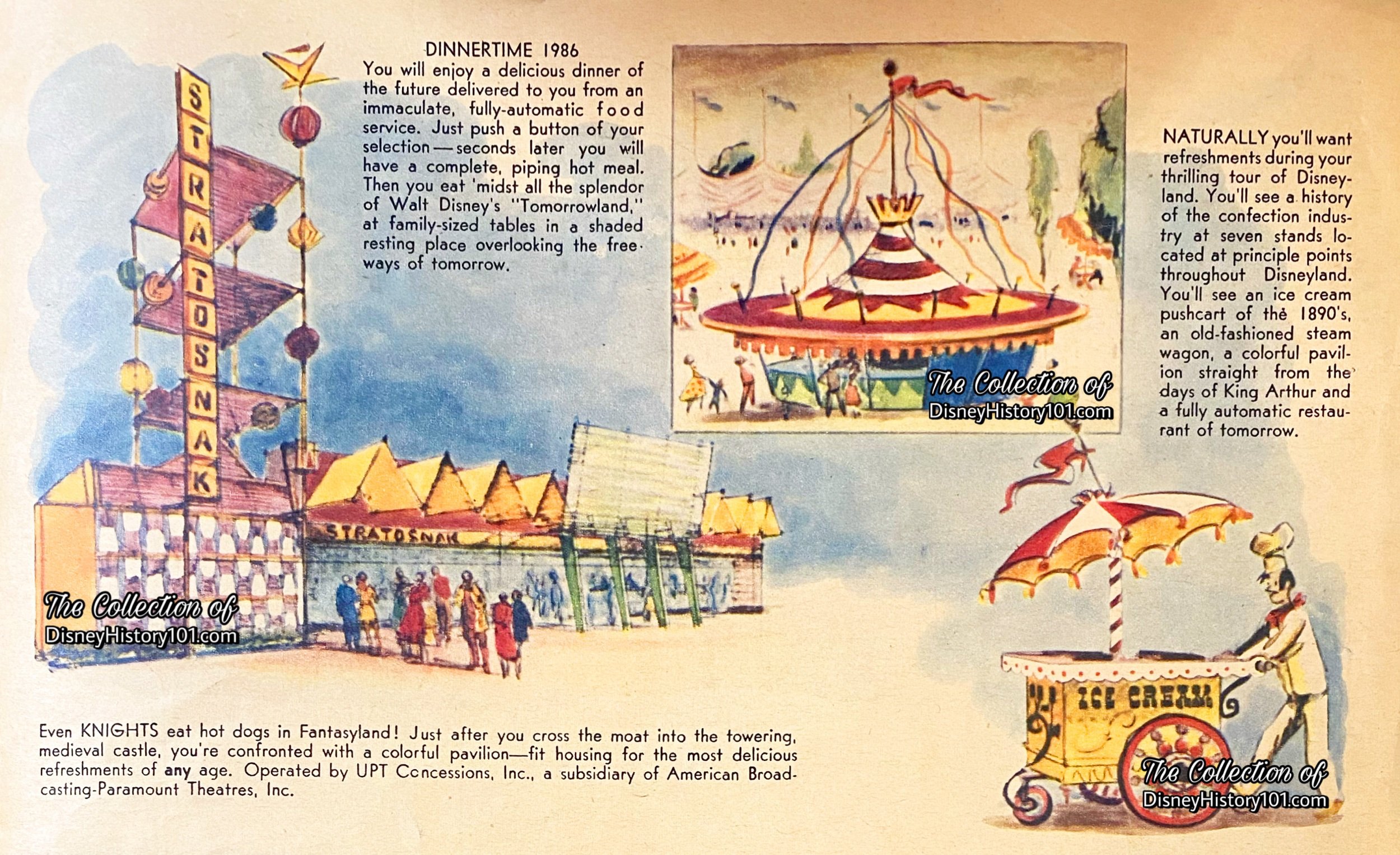
Some of these viable project Concepts (as seen above), were supported by a well-developed business case and built expectation.
Disneyland, Inc. continued to team with the Participant sponsor to develop the attraction. As late as May 25, 1955, “ABC’s Automat type restaurant… was [sic] changed from Autosnak to Stratosnak,” according to one official and authorized “Disneyland Information & Nomenclature List” (prepared by Bill Cottrell of Disneyland Inc., by May 25, 1955). It was estimated that the Stratosnak Space Bar would have the capacity to serve 800 guests per hour. With that, the Space Bar would become one of Disneyland’s eating facilities which was predicted to contribute to accommodating “15,000 persons daily, hitting a peak of 60,000 on holidays and week-ends…” and one of “twenty restaurants and snack bars, capable of saving 8,000 hourly,” at least according to “Building A Dream” (prepared by the Disneyland, Inc. Public Relations Department).
As of June 2, 1955, C.V. Wood Jr. sent an Inter-Office Memorandum to Walt Disney regarding the best estimates that could be obtained at the time regarding the completion status of individual sections of the Park and Opening Day. C.V. wrote: “Stratosnack: Will be completed.”
“55er” Dean Penlick was a Chef Manager in a very successful Beverly Hills Restaurant when it was purchased by the American Broadcasting Company. Then UPT was the Lessee for all fast foods in Disneyland, and brought Dean to Disneyland as a food consultant.
“55er” Marion Schawacha recalled opening day: “The waiting lines were all mixed up and criss-crossing each other. The line from Autopia would end up at the Space Bar, and vice versa. All you could see in Tomorrowland was PEOPLE!”Beginning in July of 1955, a variety of food and refreshments were available! Guests could order soft drinks (Root Beer, Coca-Cola, Pepsi-Cola, and Orange Drink), salads, sandwiches (hamburgers, hot dogs), desert (pastry and pie), Coffee and candy. Carnation Farms would also serve this and 14 other wholesale customers who operated restaurants and snack bars in Disneyland.
Dean Penlick recalled: “I was working in Tomorrowland at a food facility that was an automat. It was all vending machines. This operation would take in many thousands of dollars a day in coin… but we were too busy to count the coins. So we worked up a formula where we weighed the coins and used that weight as a basis for our deposits.”
A few Disneylanders fulfilled a starting role at the Space Bar, like Terry Carnes.
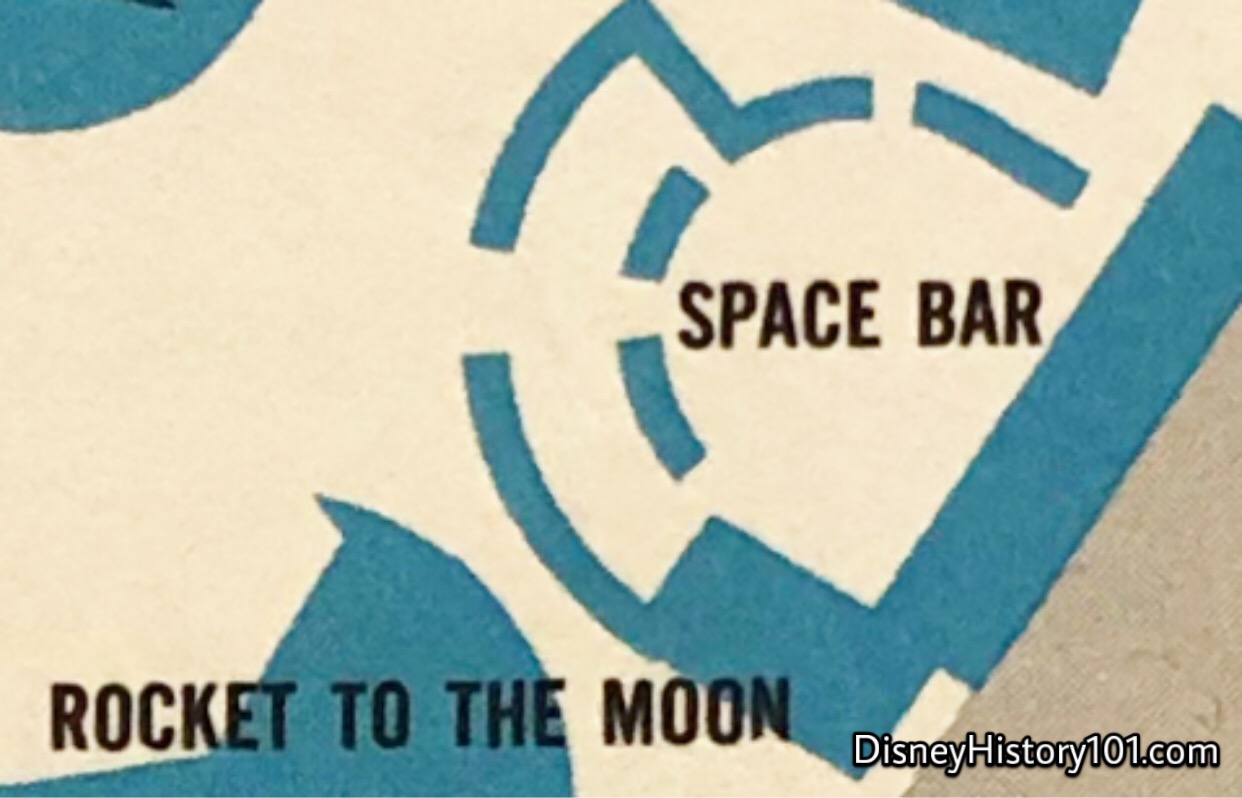
Guests selected these items from immaculate, fully-automated vending machines, and placed them on their trays, before making their way toward the Patio Seating area. The Space Bar Patio Seating Area was located in a rather central location - providing a great view of several attractions, like the busy Tomorrowland Autopia race track and (later) the Skyway cabins ascending from the Tomorrowland Skyway Station! This early Disneyland Map excerpt (though rather simple) gives an idea of what the Space Bar Patio’s table arrangement under the Space Bar awning looked like.
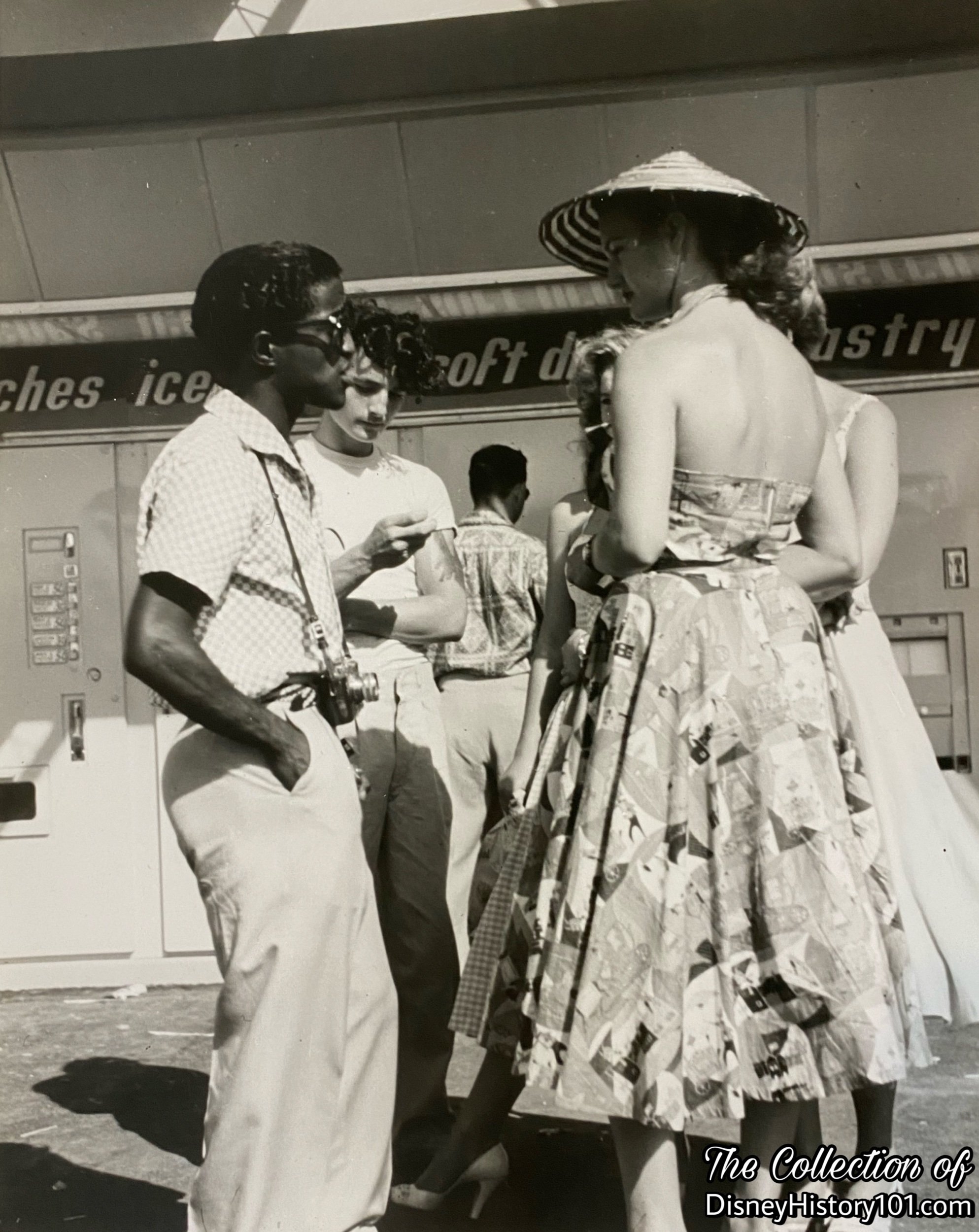
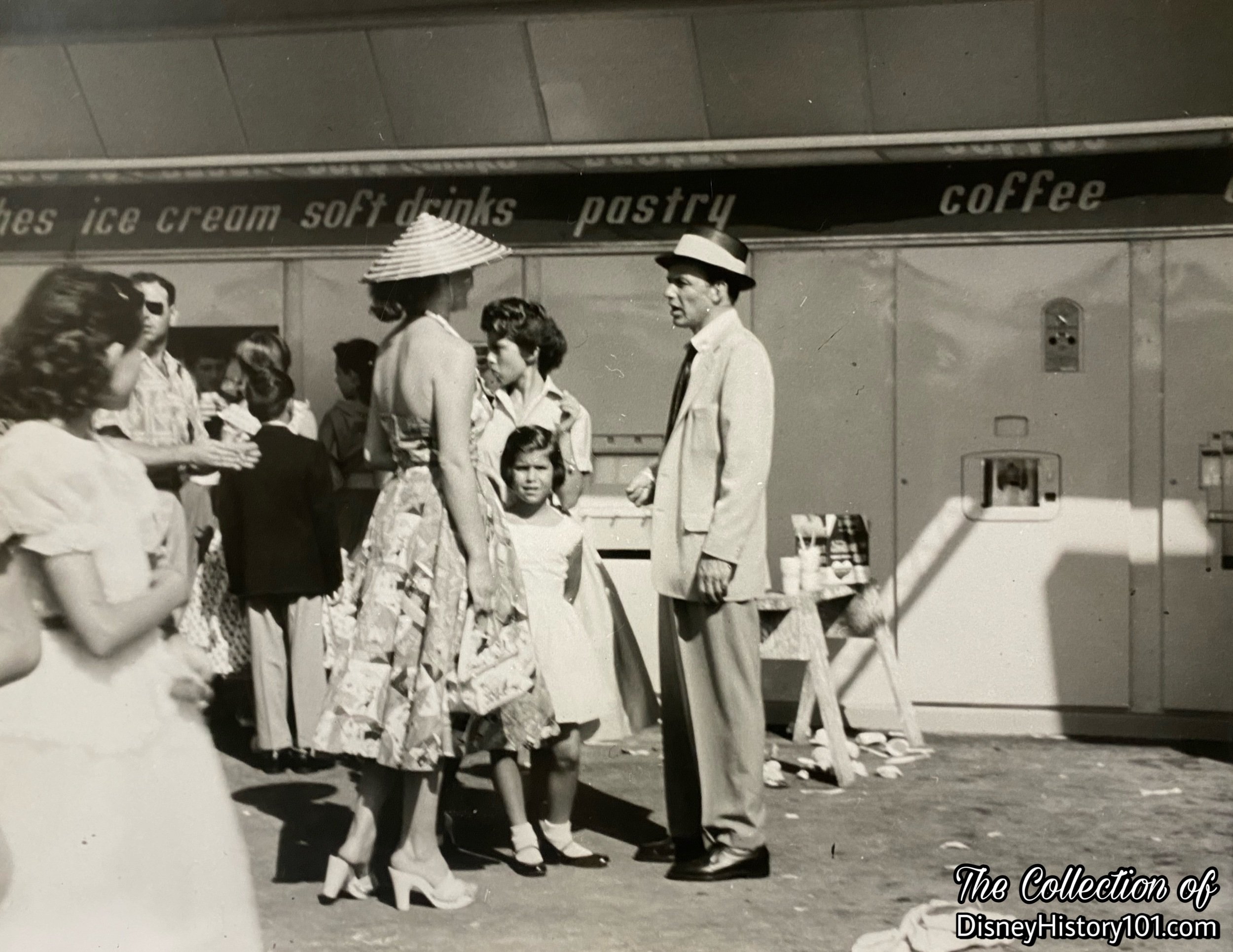
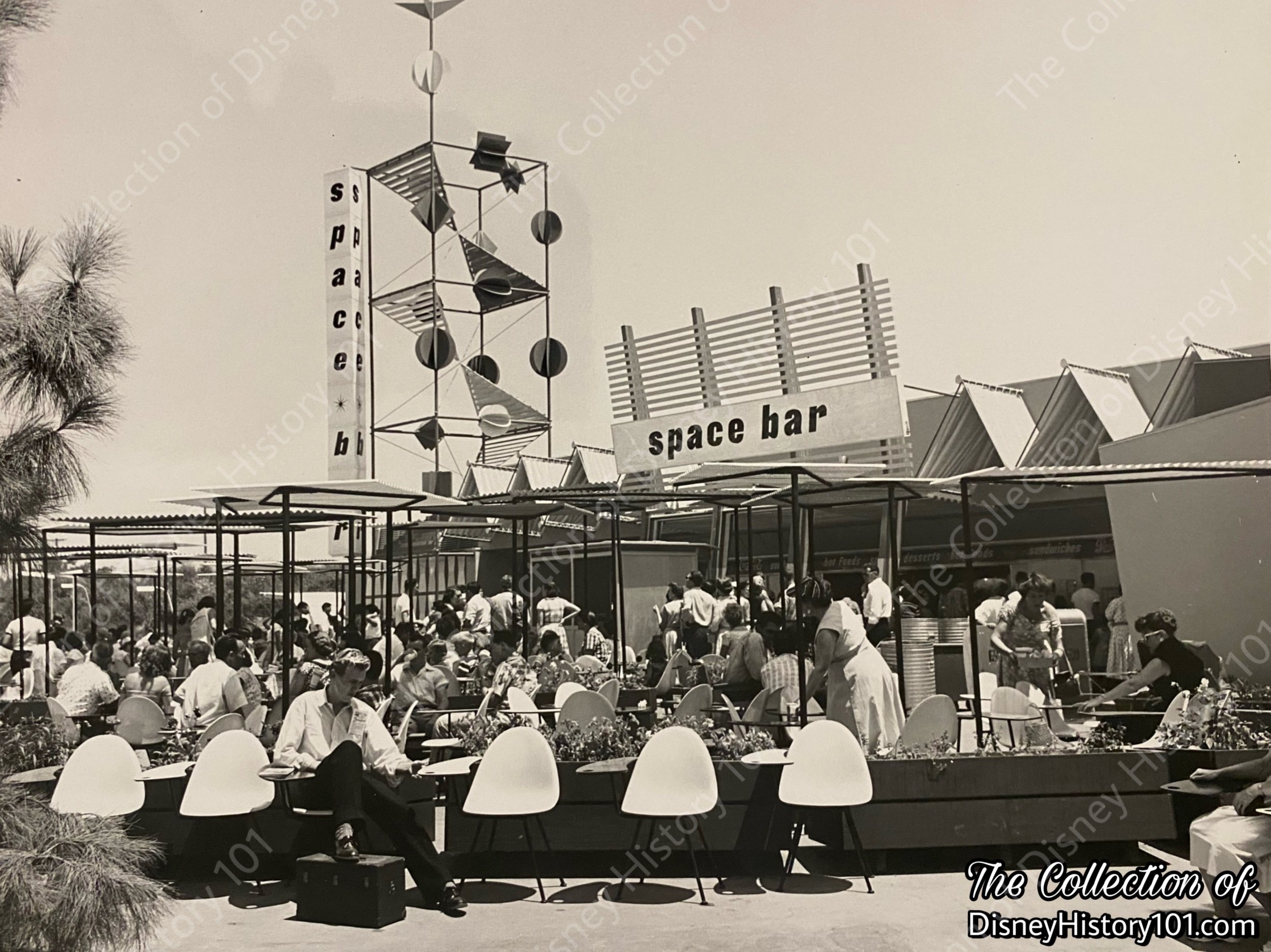
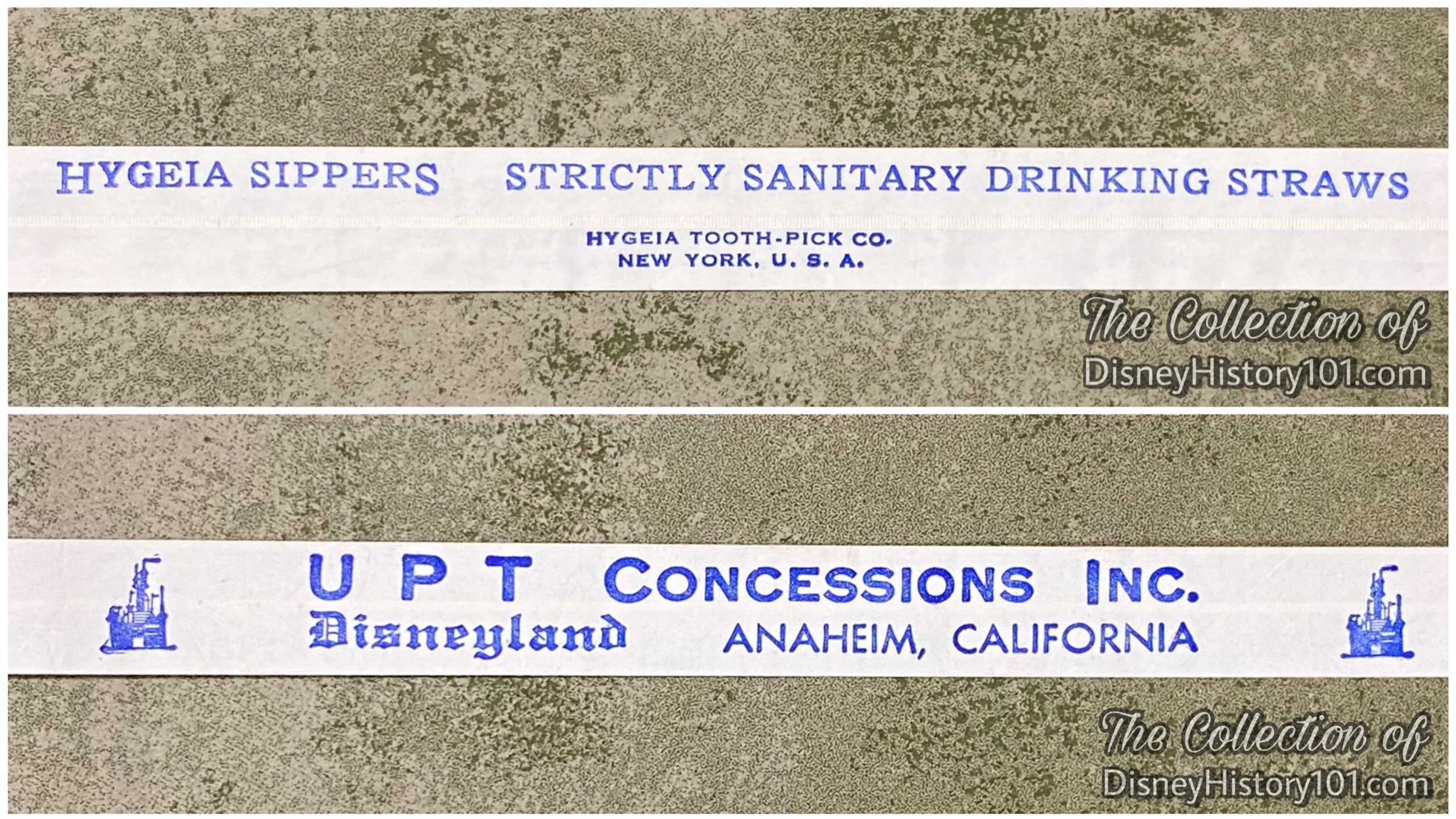

The Space Bar was operated by U.P.T. Concessions with a scope of sales on snacks and soft drinks for VIPs and Disneylanders. Marion Schawacha recalled: “Walt was a fantastic man...he had great pride in the place. He liked popcorn and he liked hot dogs and he would always PAY for his food! Instead of taking his guests to a fine restaurant, he would bring them to the SPACE BAR!”
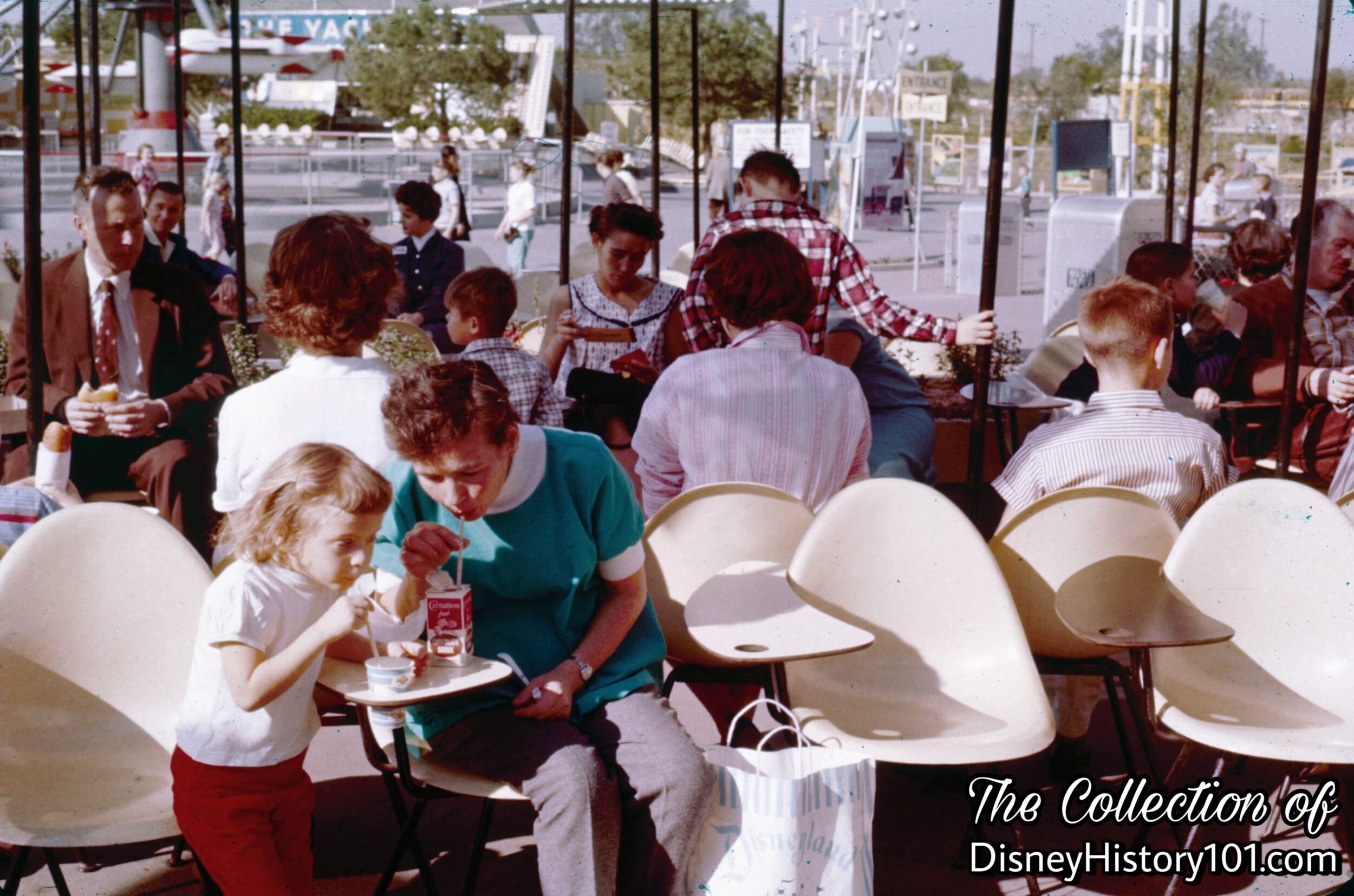
Additional covered seating was available nearby, offering another amazing view of Tomorrowland! At one time there were a total of 26 metal canopies (measuring 4’x4’) on steel posts.
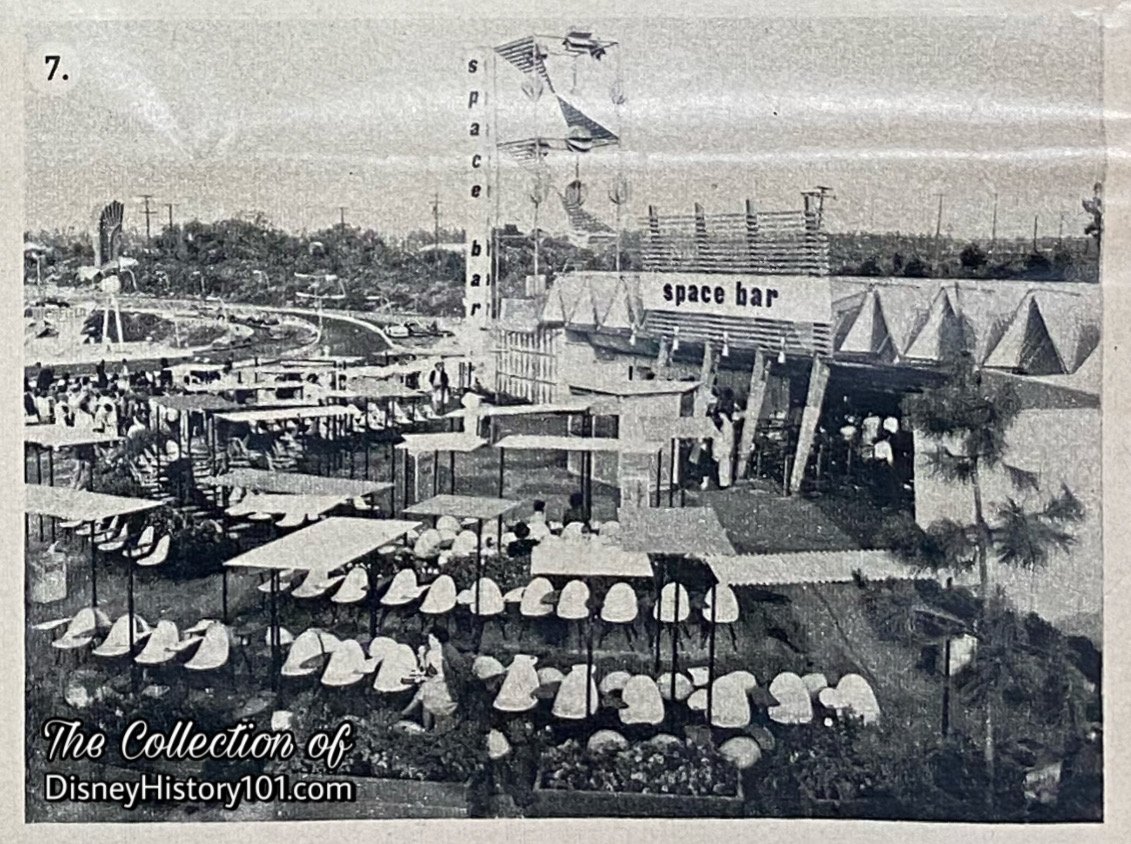
In a move of corporate synergy, the Space Bar was one of 16 Disneyland “eating places” which featured “fine food with fine coffee - Maxwell House,” from 1955 to 1957, as well as Carnation Farms products!
The vending machines at Disneyland also yielded some revenue for Disneyland Inc. Notwithstanding annual operating expenses (at $1,429 in materials) and repair and maintenance materials (at $15), a total of $8,497 (less $154 for expenses) for the fiscal year (52 weeks) ending September 29, 1957 and a total of $10,333 (less $1,468 for expenses) for the fiscal year (52 weeks) ending September 28, 1958.

Space Bar construction (and barriers) as seen from a shaky Skyway gondola descending into Tomorrowland.
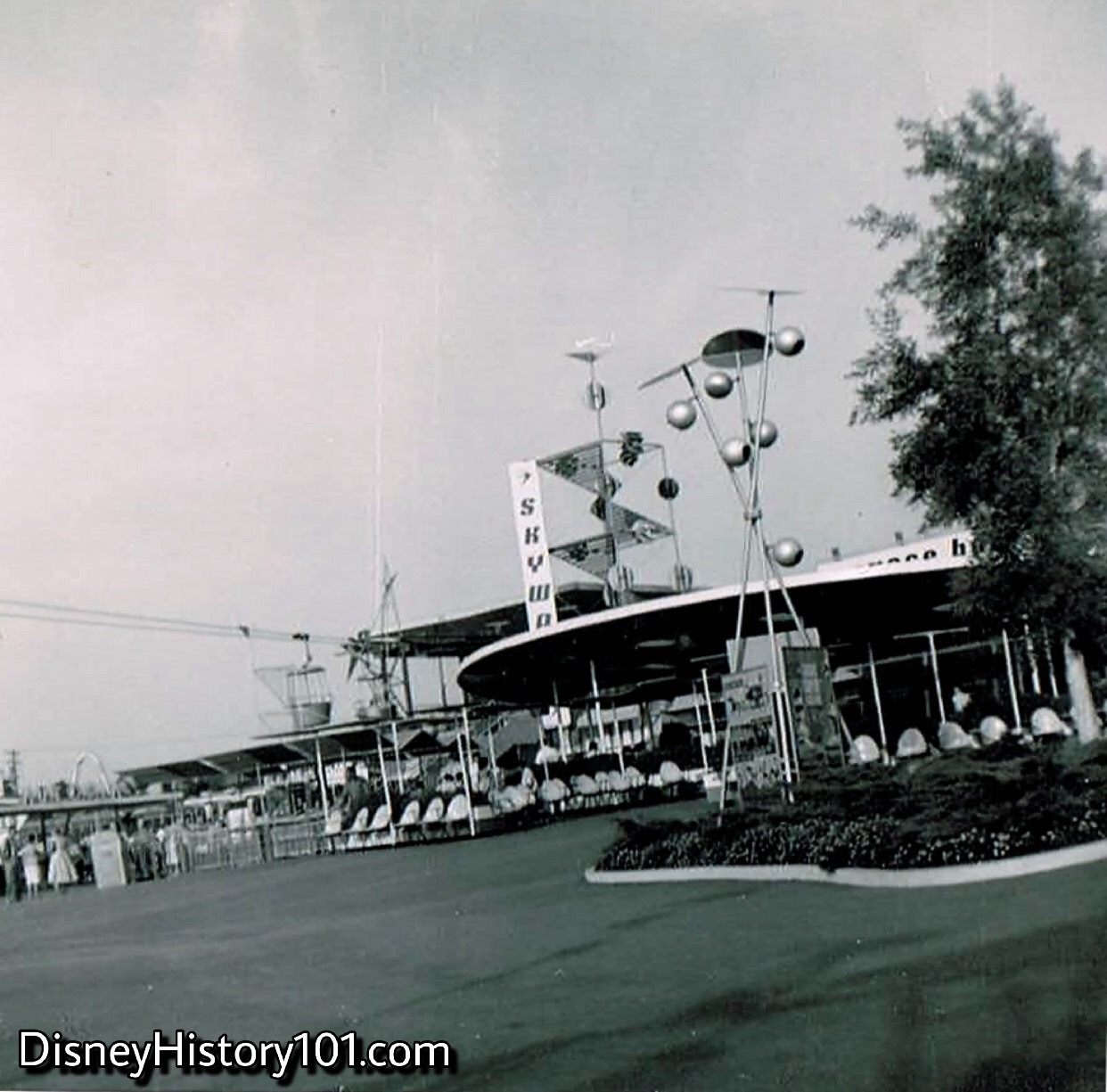
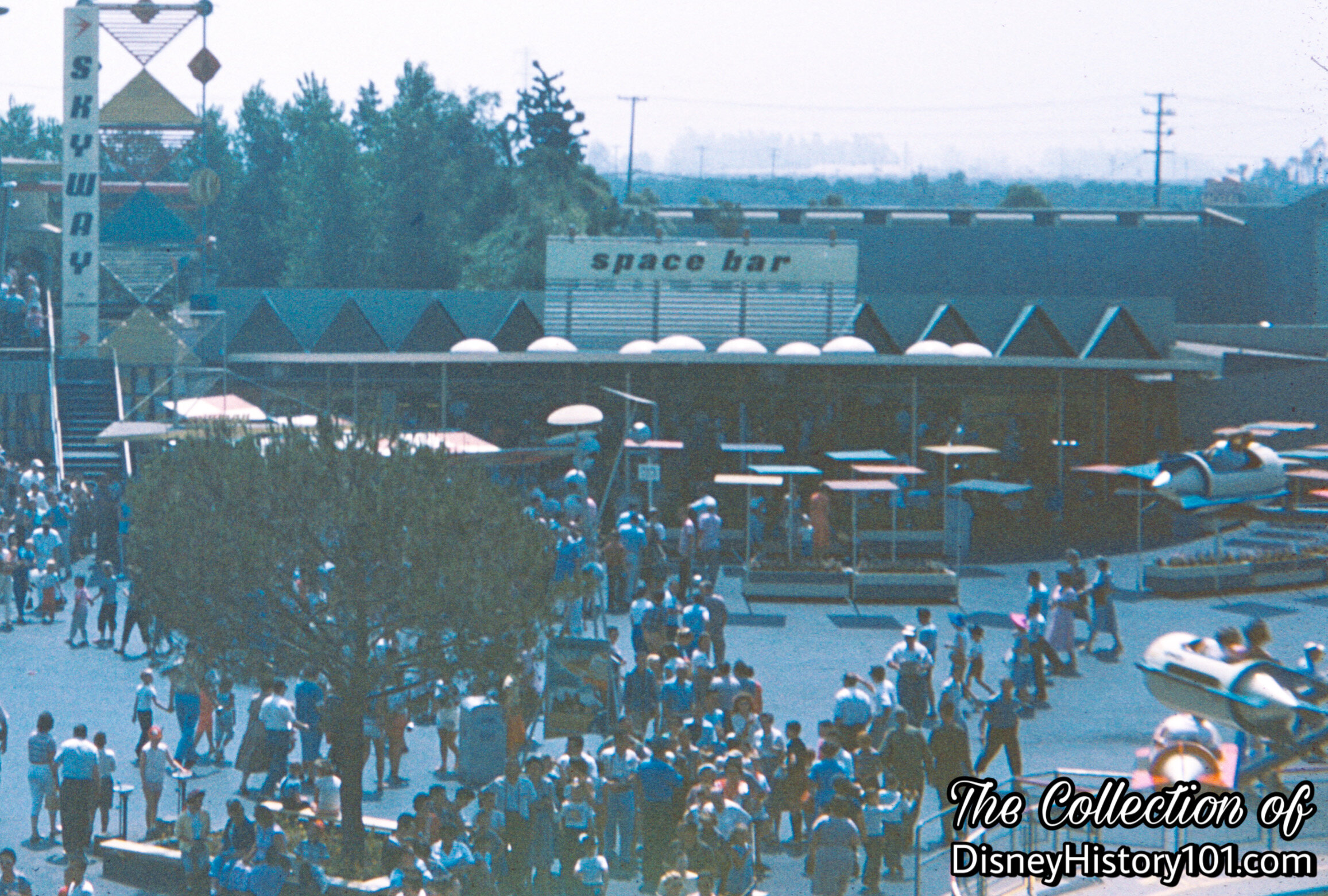
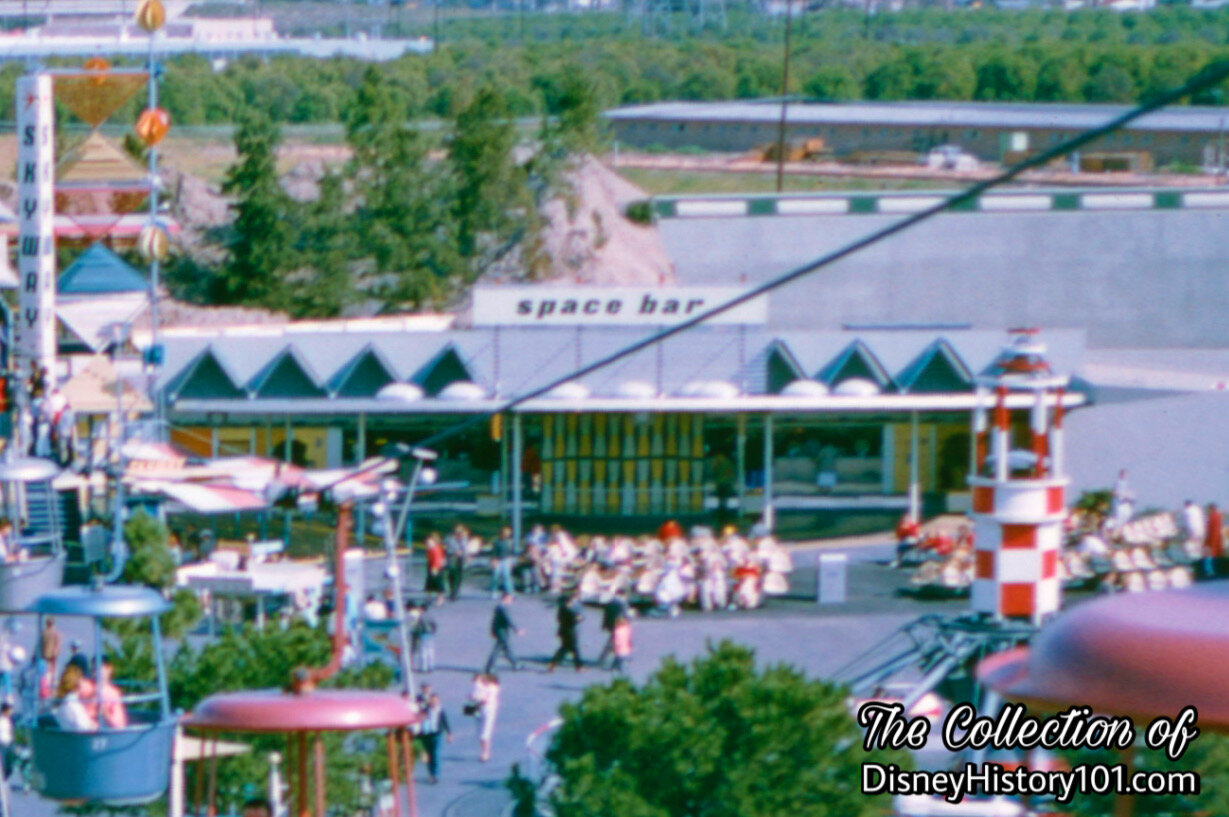
A storage addition was added to the Space Bar in 1958. After labor, materials, purchases, and sub contracts (Automatic Sprinklers, Allstate Roofers, and Jezowski & Markell), the cost of the job totaled $1,615.57. By September of 1958, an appraisal of Disneyland “land improvement” assets valued the Automat at $129,117.
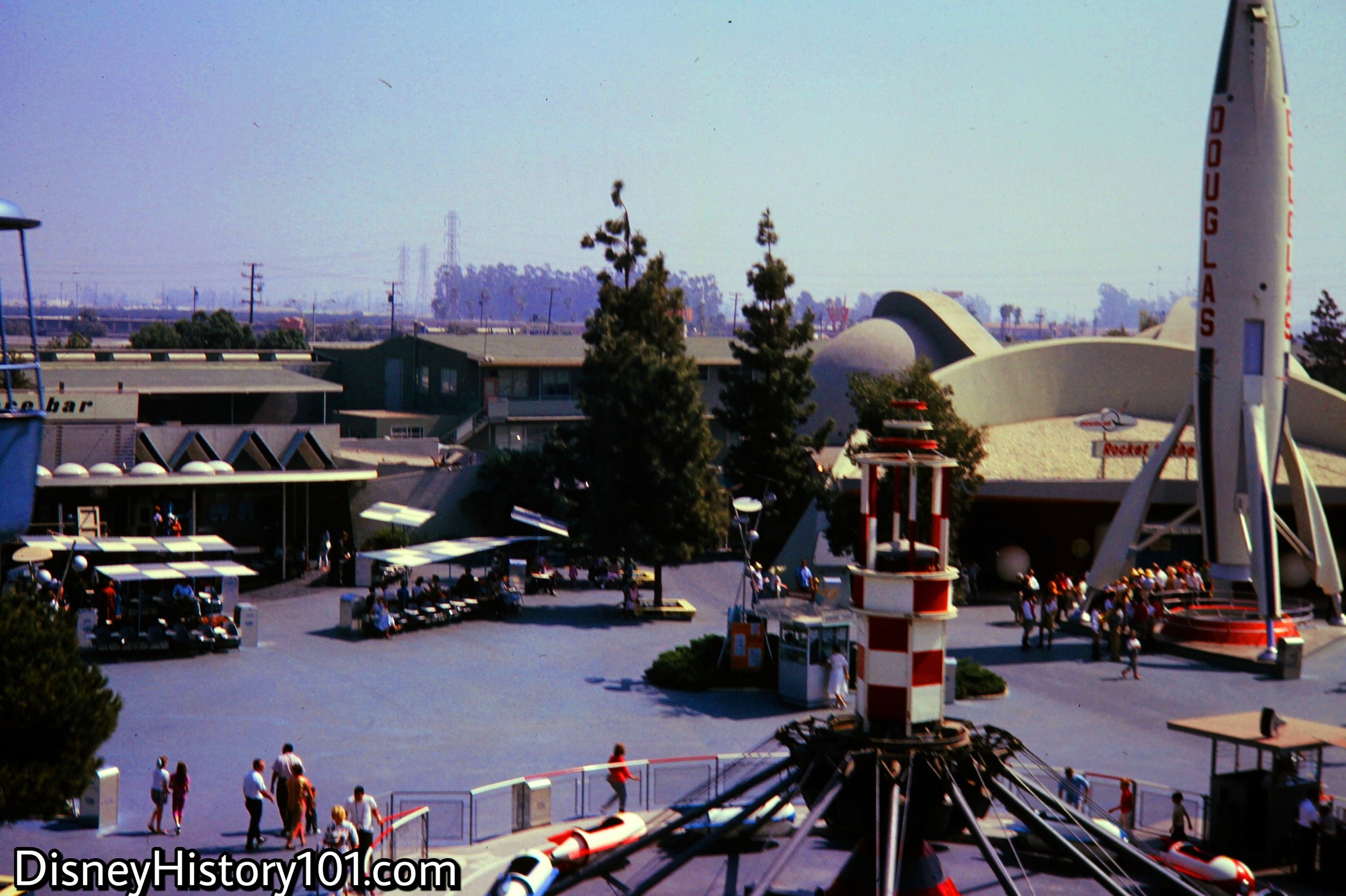
In the left corner of the photo, you’ll notice a space in the midst of the Tomorrowland “StratoSnak” Space Bar seating area. This location was often utilized for dancing and Date Night Dance bands during peak seasons.
According to Disneyland World of Flowers by Morgan Evans, “On each side of the dining terrace you will see a curious tree called ‘star pine’ (Araucaria excelsa). It comes from faraway Norfolk Island in the south Pacific, where it is known (not surprisingly) by yet another name, ‘Norfolk Island pine.’ It is not truly a pine, but a sort of second cousin. If you are a tree and have needles, and your seed is borne in cones, it's all in the family - the conifer family.”
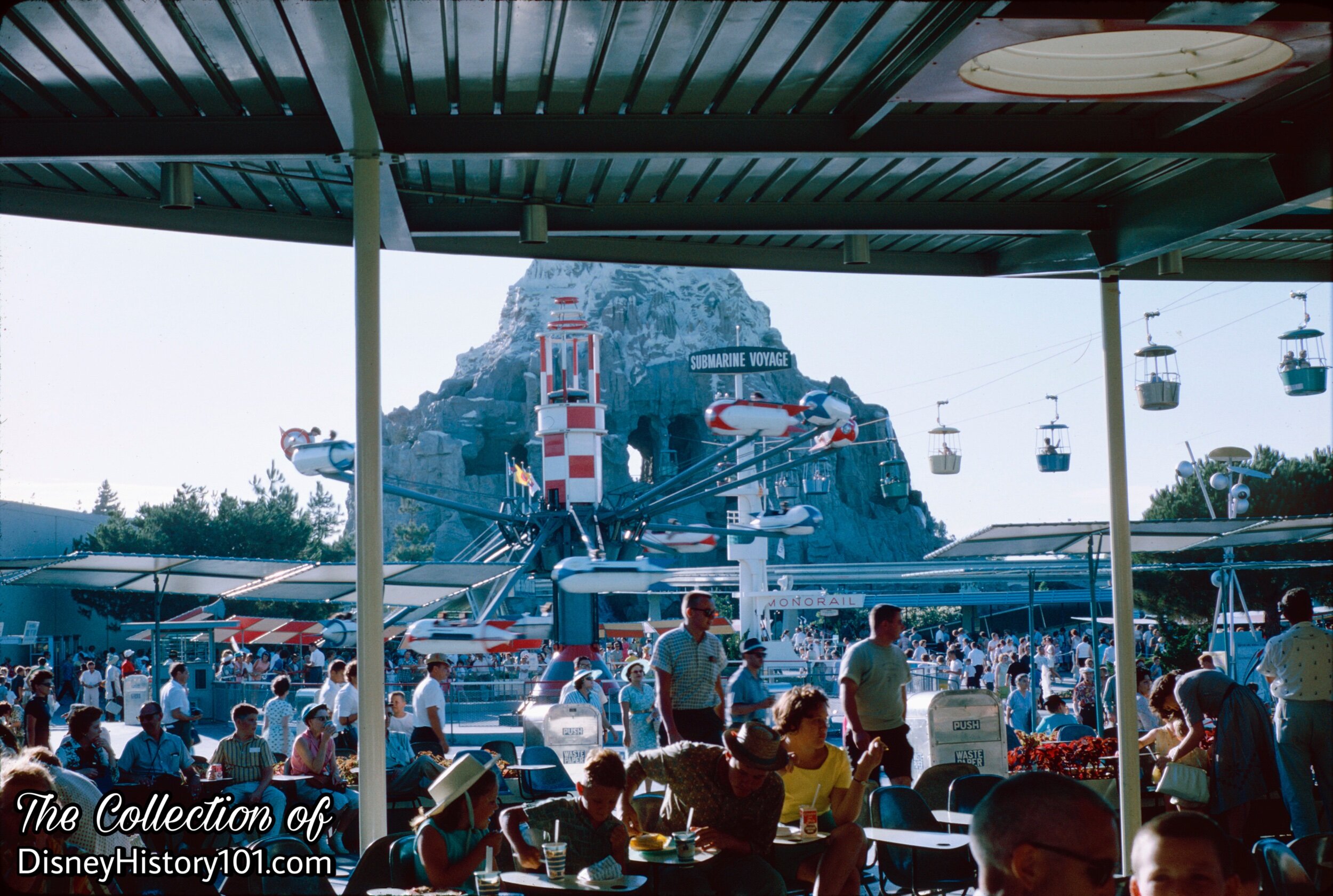
This was the view from underneath the StratoSnak Space Bar awning.
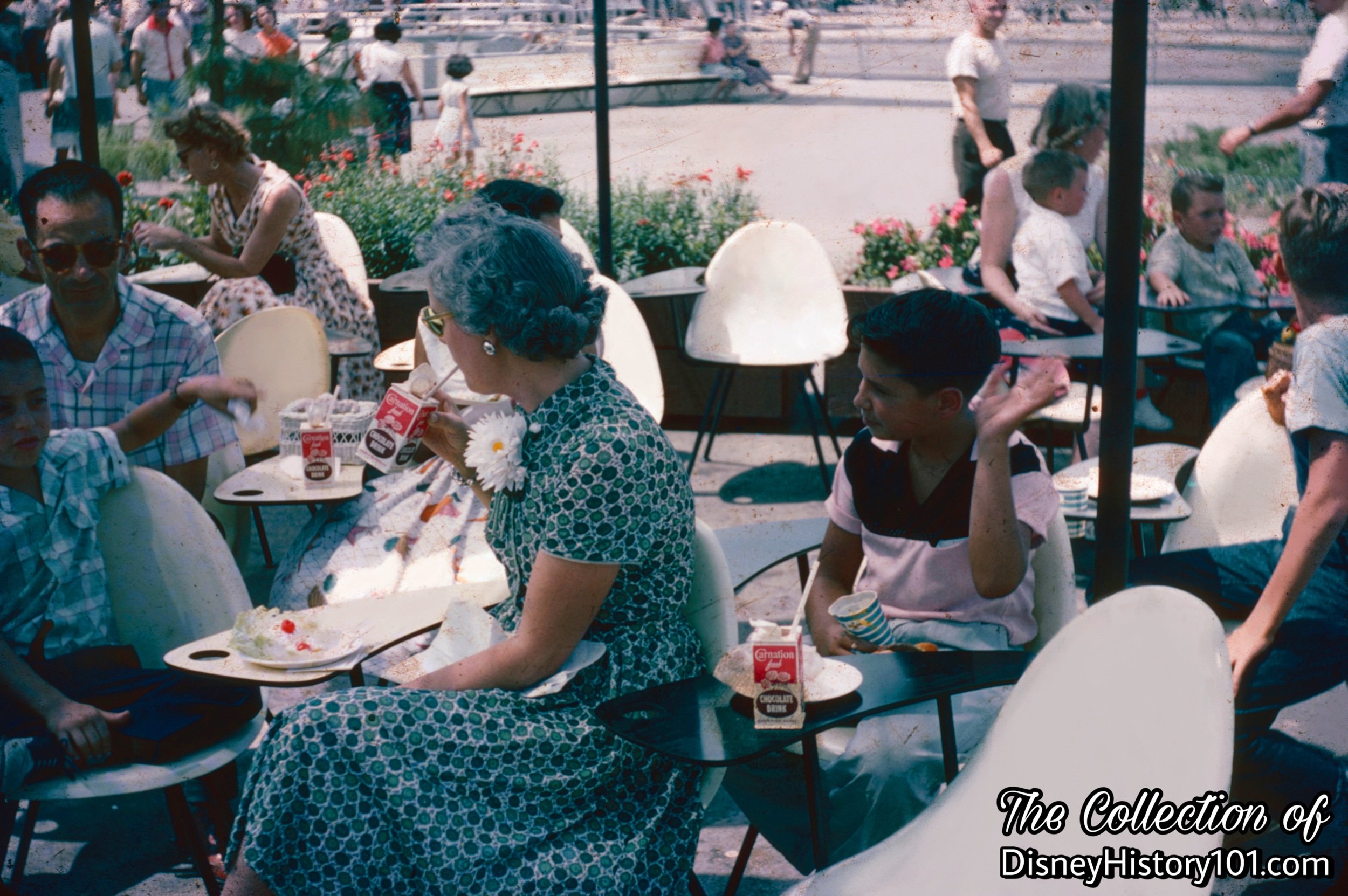
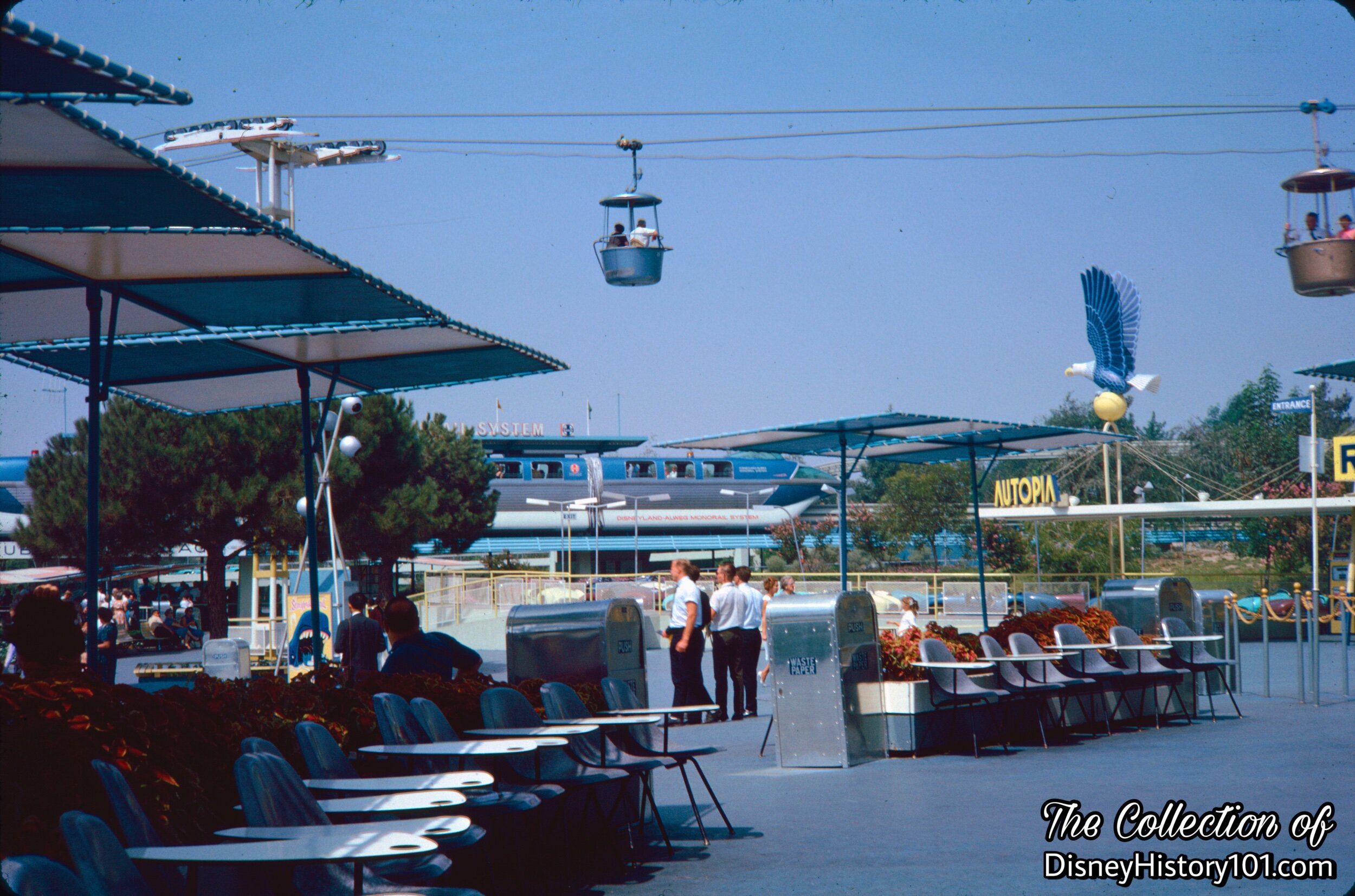
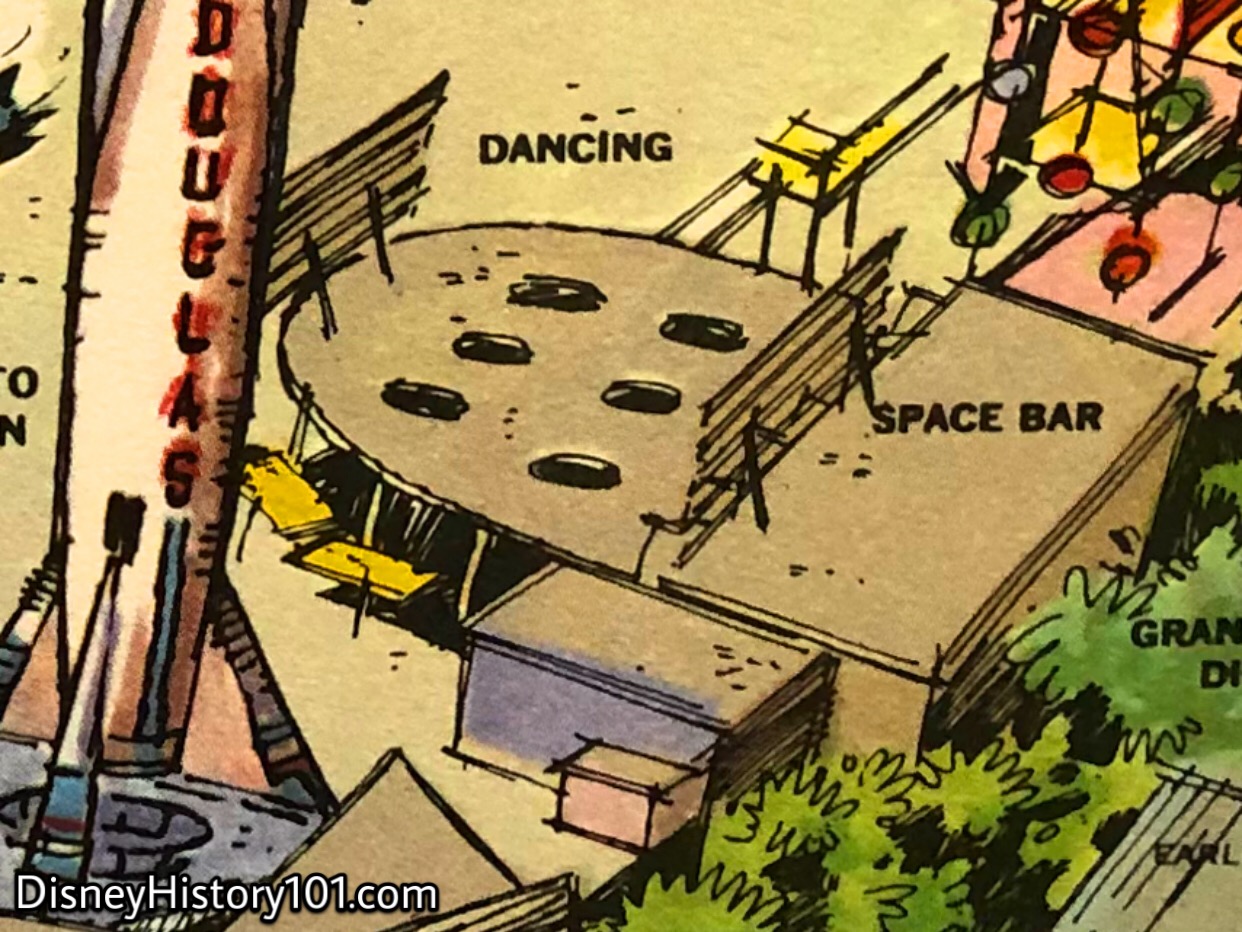
According to Dave Smith (previous Chief Archivist Emeritus of the Walt Disney Archives), “In its early years, Disneyland did not have the atmosphere bands that are used today… It would be several years before other bands appeared on a regular basis : Kay Bell and the Spacemen first performed in 1961.” [Disney Facts Revealed by Dave Smith, 2016] In addition to the usual Tomorrowland ambiance, entertainers made appearances at the Space Bar. Chuck Corson (Disneyland Entertainment casting Director, 1959 - 1973) was responsible for much of the big-name talent (and big bands) that appeared in the Park, it was Sonny Anderson (of Disneyland Entertainment) who was largely responsible for many of the youthful bands that performed at the Space Bar (and later, Tomorrowland Terrace). Acts like the Mustangs and the Spacemen owe their appearance at Disneyland, predominantly to Sonny Anderson.
The area had a permanent, covered dance floor for Date Night dance bands during peak seasons. Guests also found plenty of room to swing at the Space Bar Dance Area (labelled in some guides like “Walt Disney’s Guide to Disneyland”, published 1964). Both the Space Bar Band (debuting during the summer of 1961), and the Astronauts (the band) could be found providing swingin’ melodies during Date Nites (perhaps starting during the Summer of 1961) at the nearby the Space Bar! During 1962, both Teddy Buckner and his Band performed during Disneyland’s 2nd Annual Grad Nite, and Bobby Rydell performed in a segment of “Disneyland After Dark,” from the Space Bar Stage. The 5th Annual New Years Eve Party (held Monday, December 31st, 1962 thru Tuesday, January 1st, 1963) brought the vocalist Kay Bell and the Spacemen to the Space Bar. Grad Nite 1964 continued to bring performances by the Spacemen and Kay Bell to this dining area. Also during 1964, Gary Lewis (Jerry Lewis’ son) won the contract to perform with his six-piece rock and roll band (at the Space Bar in Tomorrowland) on Friday and Saturday nights. Charlie Barnet and His Orchestra also performed at the Space Bar.
By January, 1966, Disney had bought out the UPT facilities, a subsidiary of American Broadcasting Company.
I’m 1967, the Space Bar tarmac was raised in front to a point, level with, or just a bit higher than the dance floor.
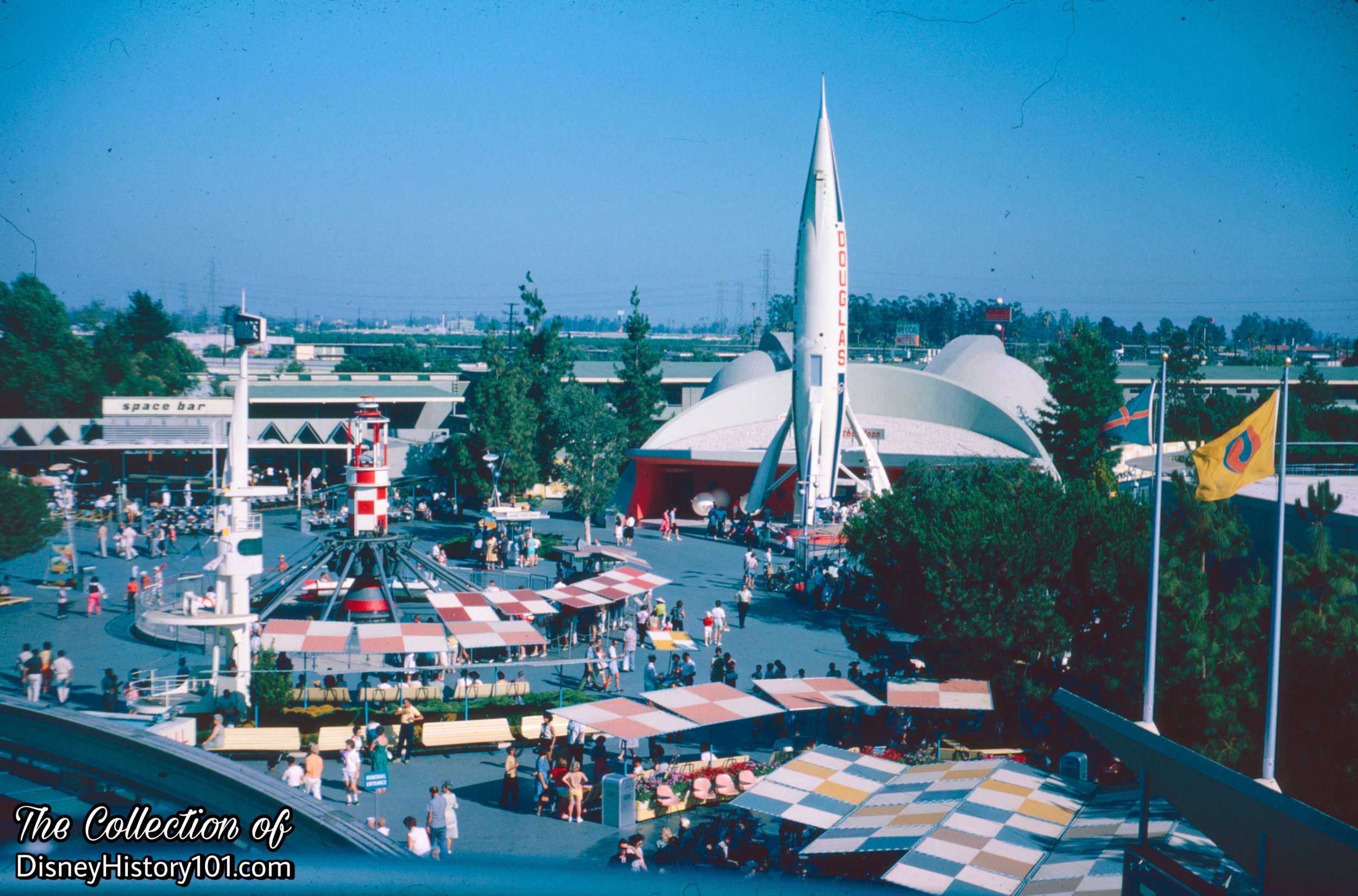
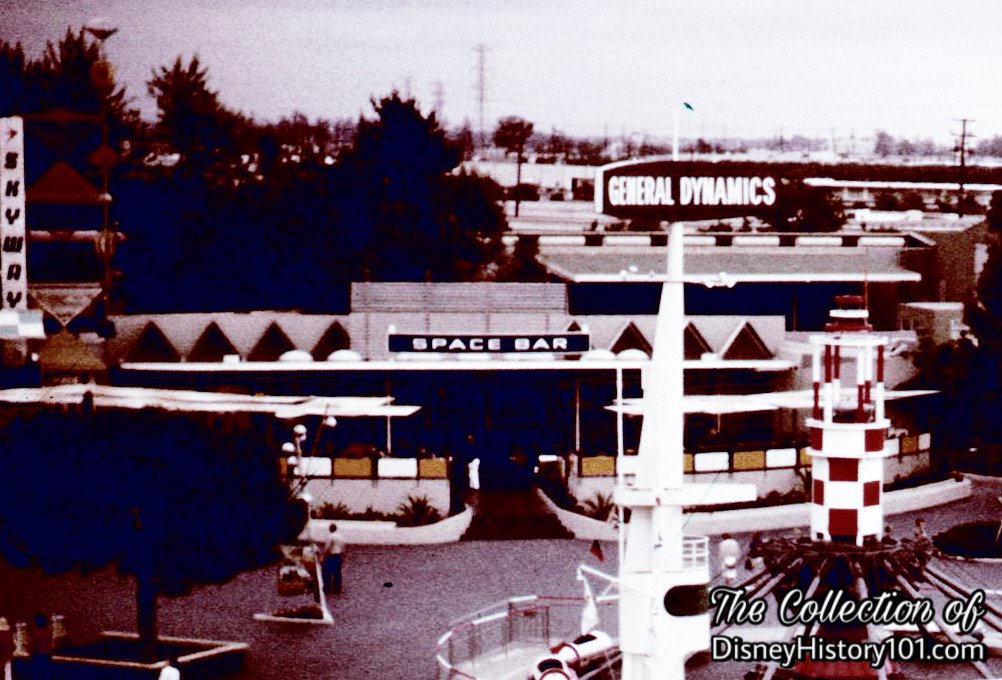
For about a decade (during the 1960s), the Patio Seating area was elevated and enclosed with panels.
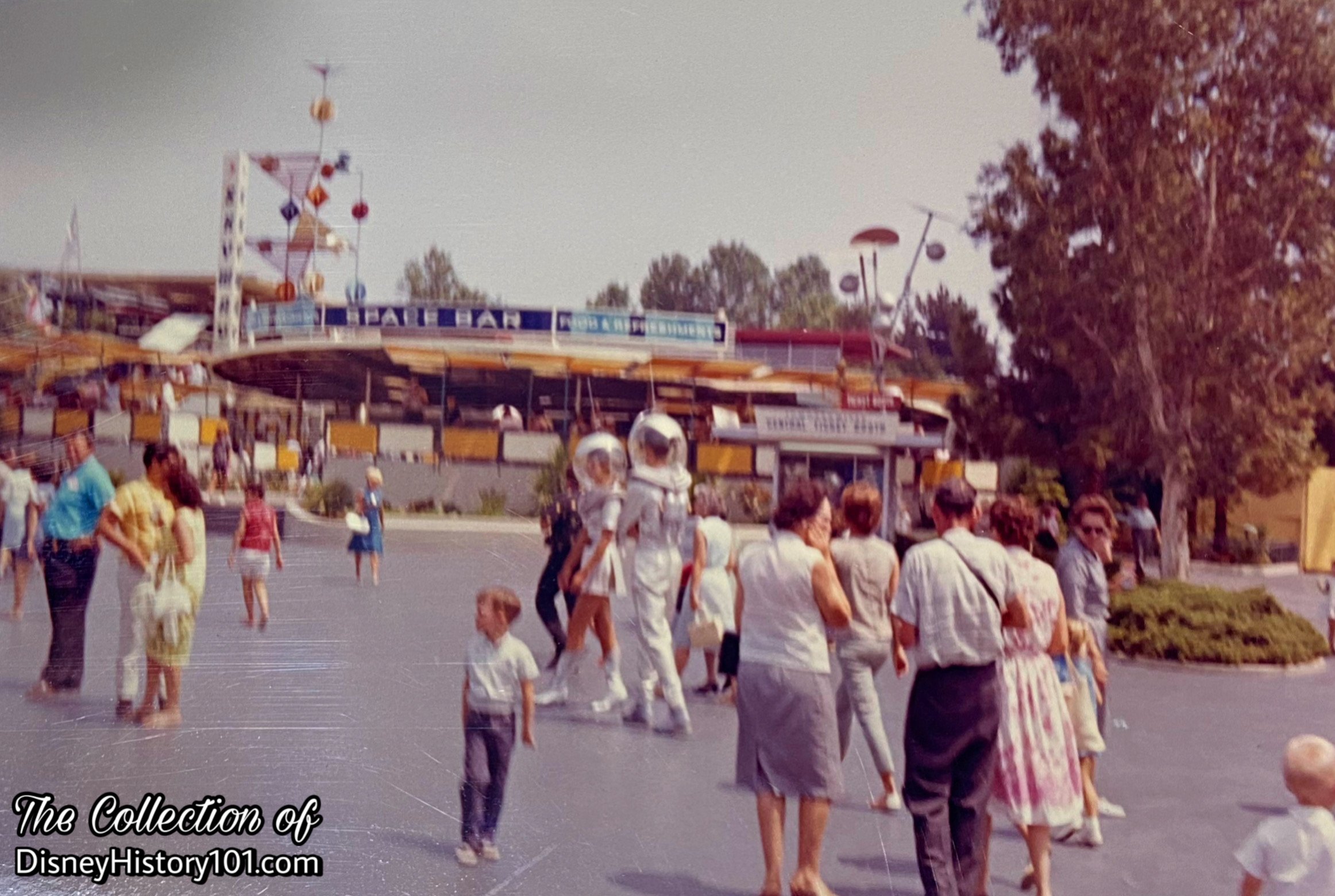

According to Bill Evans (“Walt Disney Disneyland World of Flowers”): “Yucca and Australian spear lily, seasonally highlighted by cockscomb and verbena, greet visitors to the Space Bar.”
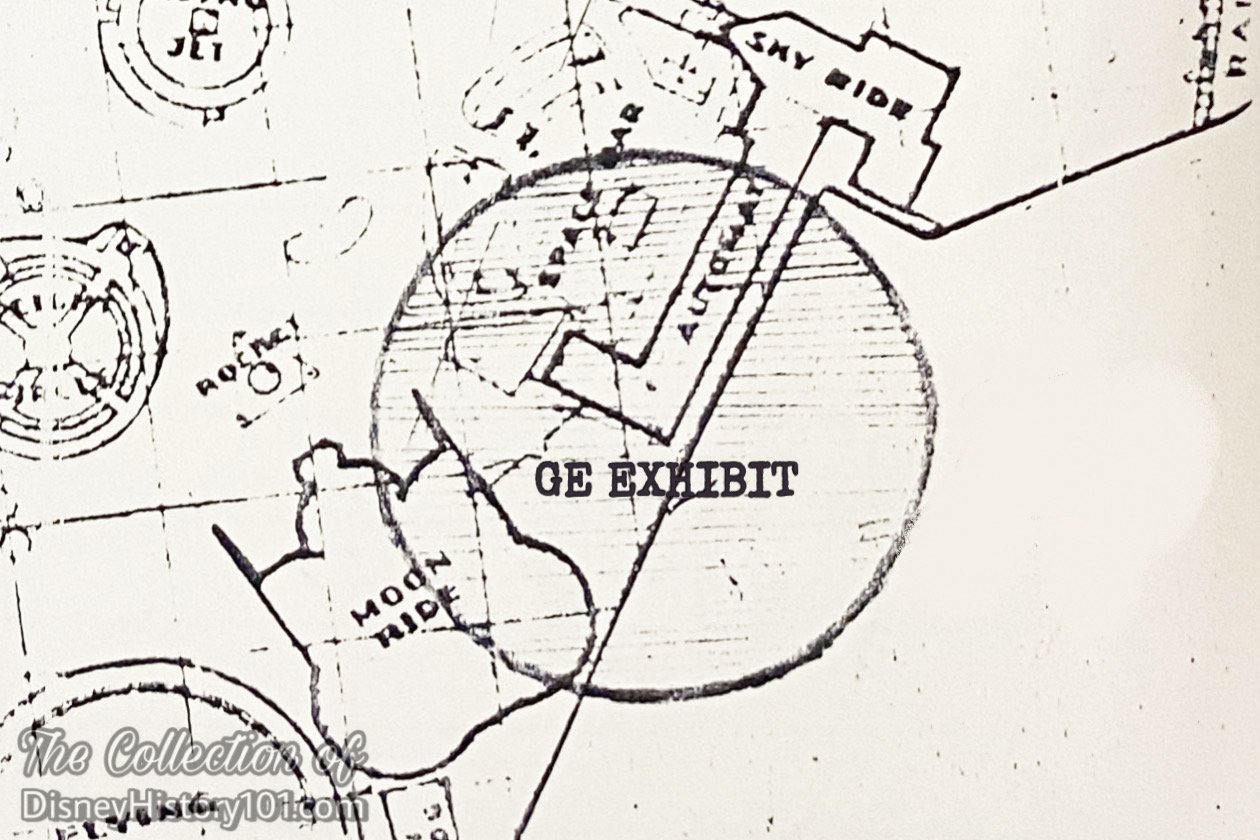
During the construction of the New Tomorrowland, the site of the old Space Bar was utilized for the Carousel Theater.
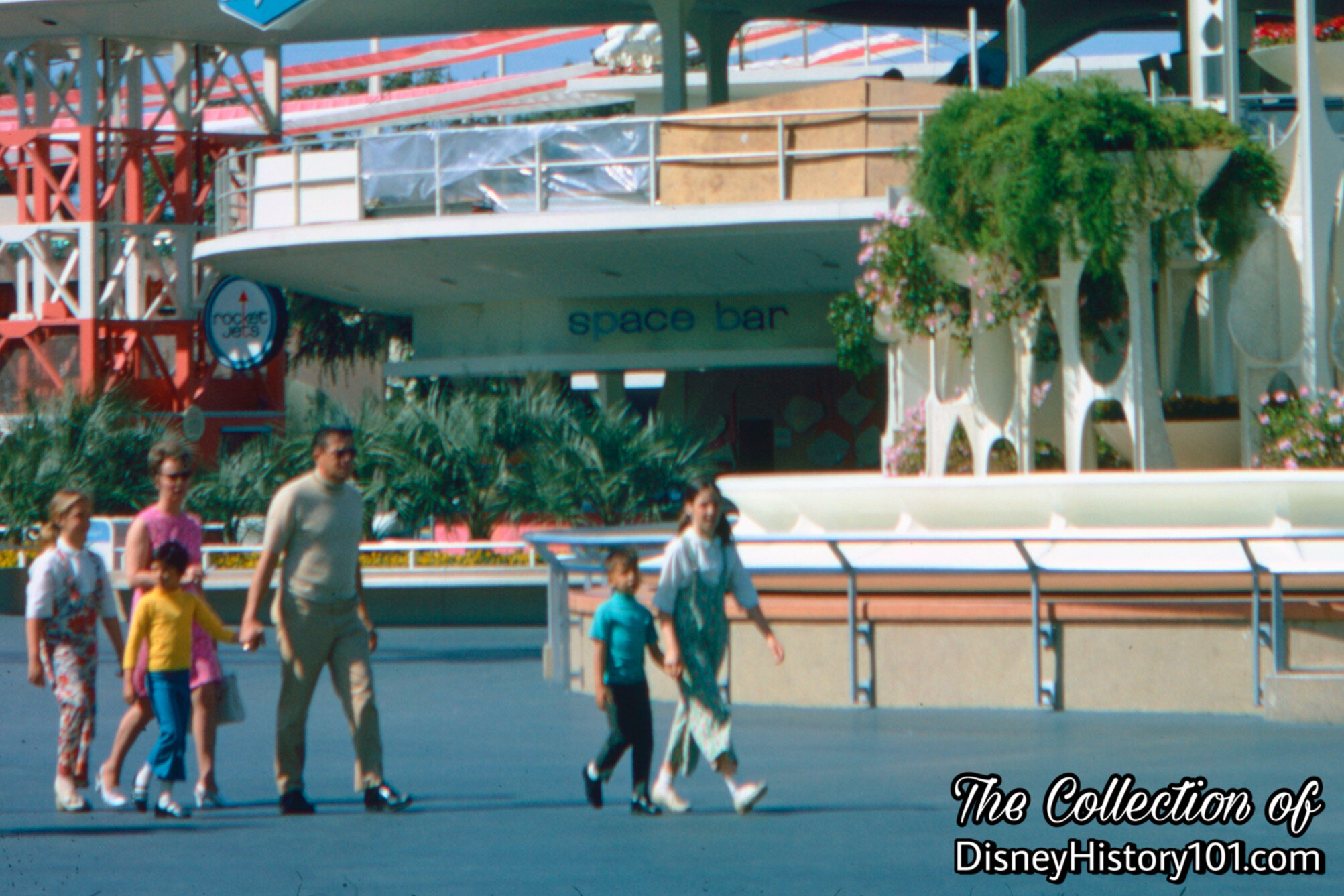
While located beneath the PeopleMover station, the new Space Bar offered “soft drinks, ice cream, popcorn and other refreshments.”
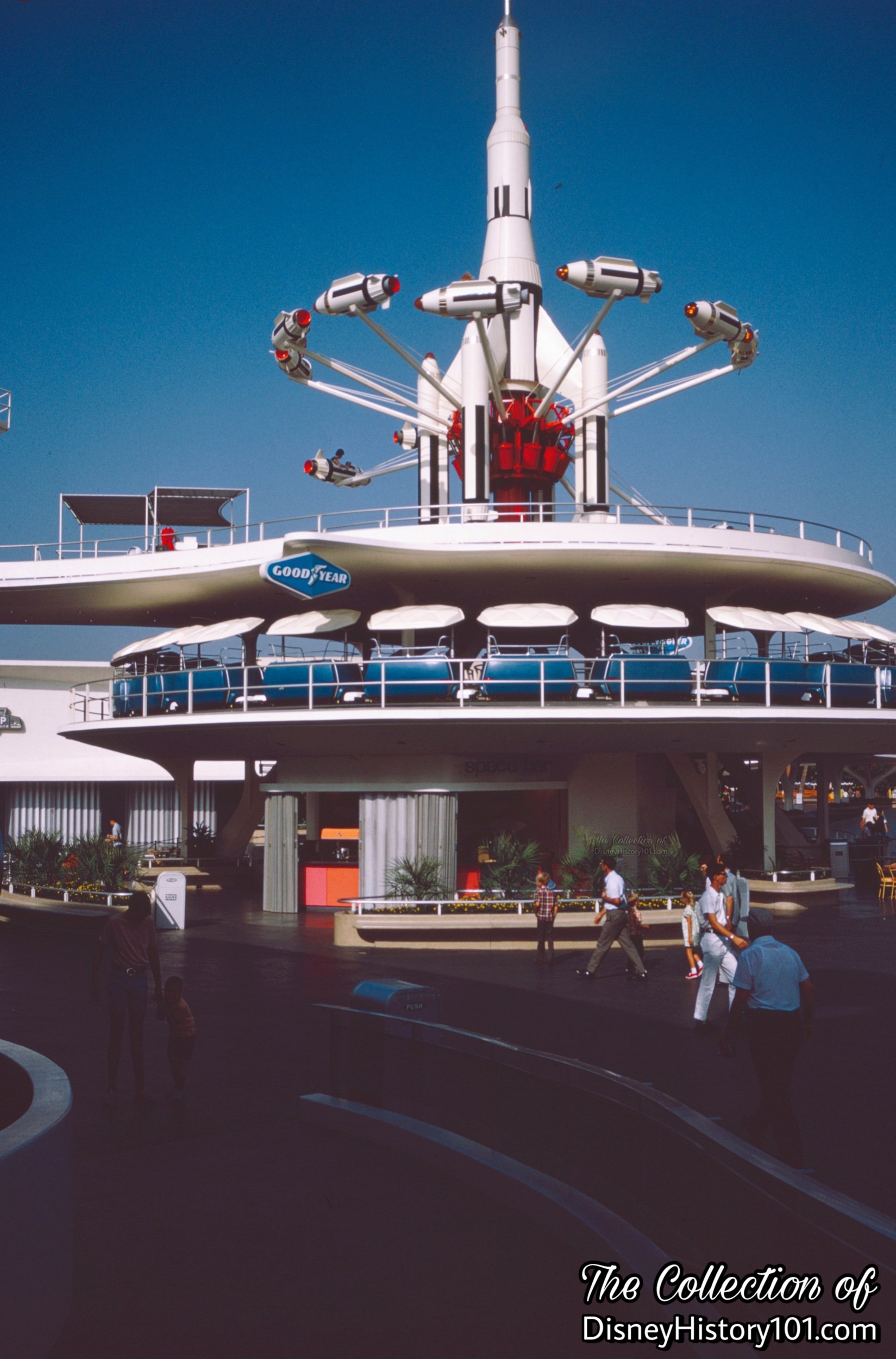
During the development of Space Mountain, a new form of the Space Bar was renamed The Lunching Pad. About 1981, the Tomorrowland fast food location offered Popcorn, Space Mist, Ice Cream Bars, Ice Cream Sandwiches, Frozen Bananas, Coffee, Hot Chocolate, Twinkies, Milk, Almonds, Raisins, and Ham and cheese sandwiches.

If you would like to read more about the original Space Bar, it’s my pleasure to recommend adding Marcy Smothers’ “Eat Like Walt - The Wonderful World of Disney Food” to your personal Disney Home Library! Therein, Marcy has extensively researched and finely crafted a small section of a chapter dedicated to “Walt Disney’s Disneyland - Tomorrowland” If you would like to bring the magic of Disneyland restaurants and concessions to your dining room table, “please step this way” toward www.eatlikewalt.com where Marcy has shared a few recipes for memorable Disneyland menu options, so you too can “Eat Like Walt.”
SPACE MOUNTAIN
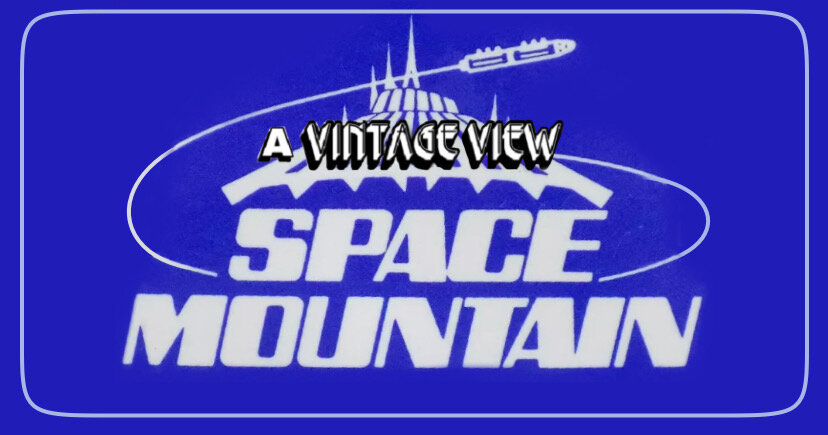
Construction : June of 1975 - 1977
Opening : May 4*, 1977
Dedication : May 27, 1977
*Disneyland Rides & Attractions and Attendance Report, Fiscal Year 1981.
One can easily slip into the jargon of “ride” but at Disneyland there are attractions and every attraction is a living experience for the guest. Disneyland ride-through attractions or adventures have officially been defined as an “individual show, ride, or exhibit designed to produce an entertaining Guest experience. Disney attractions stir the imagination, enliven the senses, and provide the participants with positive, innovative entertainment, which is the essence of the DISNEYLAND Show.”
There is also a “story behind the story” of every attraction. It is important to review the story of the attraction, tell the story, explain it, and create interest. This is the story of Space Mountain.
When Disneyland was being conceived, Walt intended that his Park have no roller coasters. However, Walt Disney also said : “Disneyland will never be completed. It will continue to grow, always adding new things to provide its visitors with exceptional and entertaining attractions.” In Walt’s eyes, Disneyland was “like a piece of clay,” because if there was something he didn’t like, he wasn’t stuck with it. He could reshape and revamp it. After years of personally reshaping and revamping, Walt divulged: “I’m not the perfectionist anymore. It’s my staff - they’re the ones always insisting on doing something better and better.”
The success of the Matterhorn Bobsleds a few years prior (in 1959), had proved the viability of thrill rides within Walt Disney’s Magic Kingdom! While some early research and development was conducted through Arrow Development, Space Mountain would become one of the Park’s first roller coaster-type attractions to be developed through WED Enterprises. In 1964, Walt assigned WED Enterprises artist “Captain” John Hench (an old sketch artist from the Hyperion Avenue Studios era of 1939; a background artist) with the task of researching and creating initial concepts and sketches for future indoor roller coaster attraction at Disneyland. This potential adventure would be included in the New Tomorrowland expansion project of the mid-1960s.
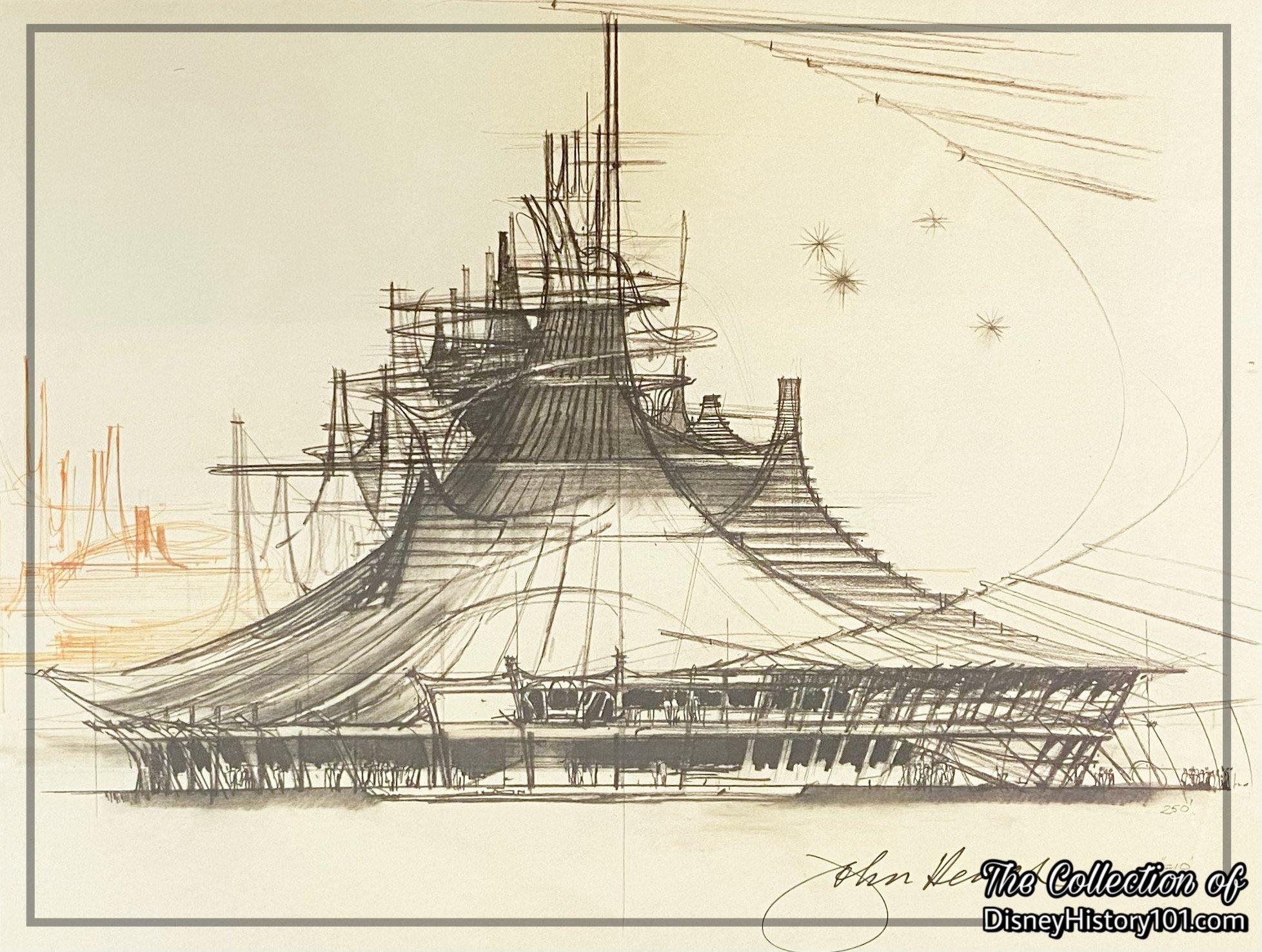
Walt Disney’s Imagineers knew their audience. Even while Tomorrowland featured the Flying Saucers attraction, early 1960s maps began to depict another space-themed attraction - a “Spaceport & Rocket Flight Future Attraction” (also referred to as “Space Voyage.” Some of the earliest visions of the Show Complex Building (with its towering white spires) were created by the Legendary John Hench, who made “the first little sketches on the thing.” Even such early renderings proved that the building was designed to have ”draw concept” - designed in a manner in which it would generate interest and beckon the observer. In the words of John Hench, “It's all very obvious: careful communication, watching what you say, and being explicit and having something to say in the first place.”
According to Marty Sklar “I like to think that I interpreted and reinforced Walt's creative approaches because it was really Walt Disney who set this whole thing up. I've worked hard to be the champion of Walt's philosophy and values over the years… John Hench was the king of design, but even being as smart as he was, he wasnt able to communicate easily down the line, so there was a role for me in helping to achieve what the great designers had developed.” [“Ripley’s Pioneers: Legends of the Amusement Park Industry Volume One” by Tim O’Brien]
“Disneyland is unique in that some of the world's foremost creative artists and architects control all design at Disneyland.“ Walt Disney Productions artist Herbert Ryman was influential to some exterior elements, while some interior settings were sketched by WED Enterprises Employee George McGinnis. Notable WED Enterprises, Inc. engineers and artists like Bill Watkins and Roger Broggie Sr. would also be involved in the development of the space adventure - “Space Voyage”!
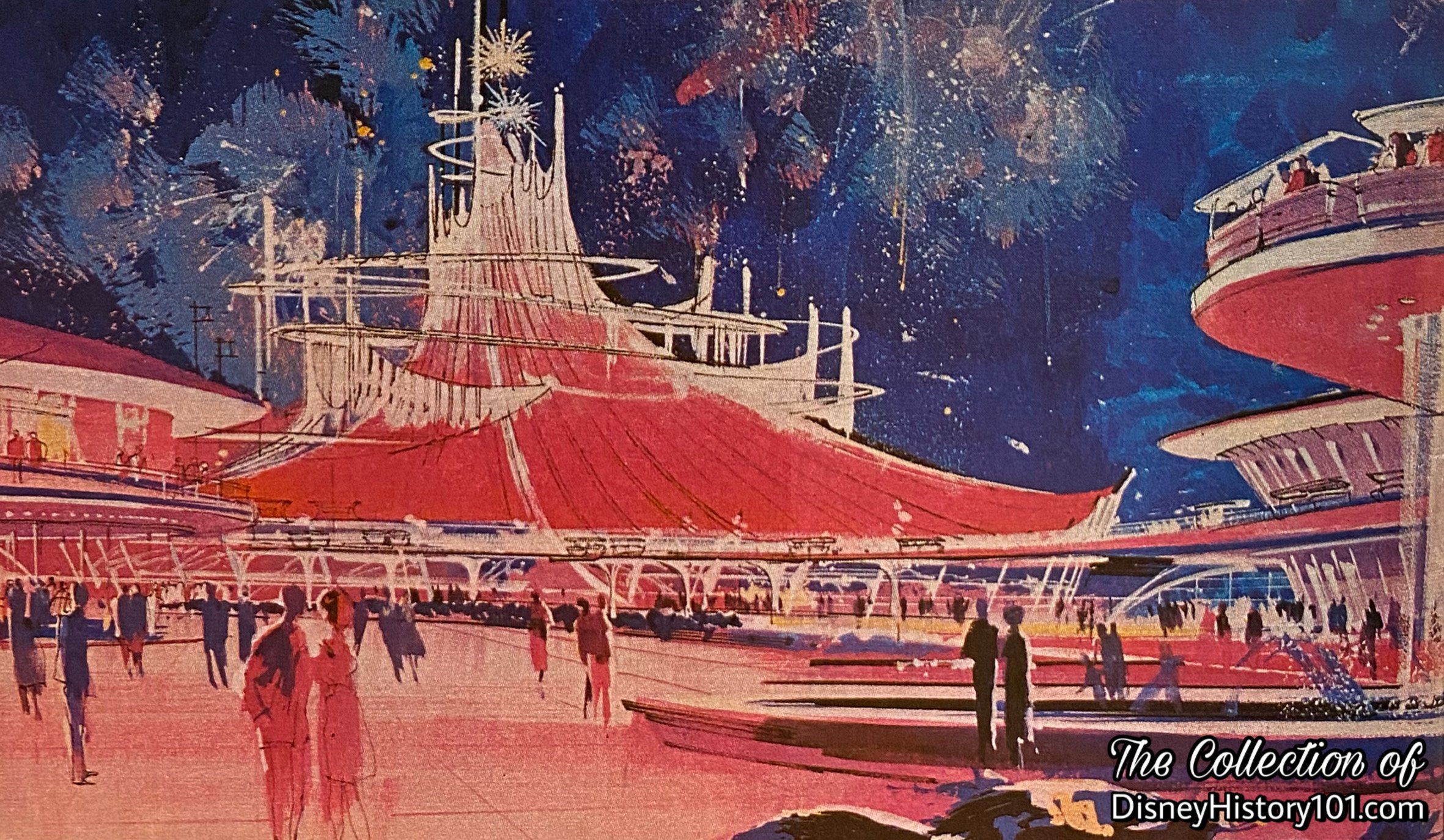
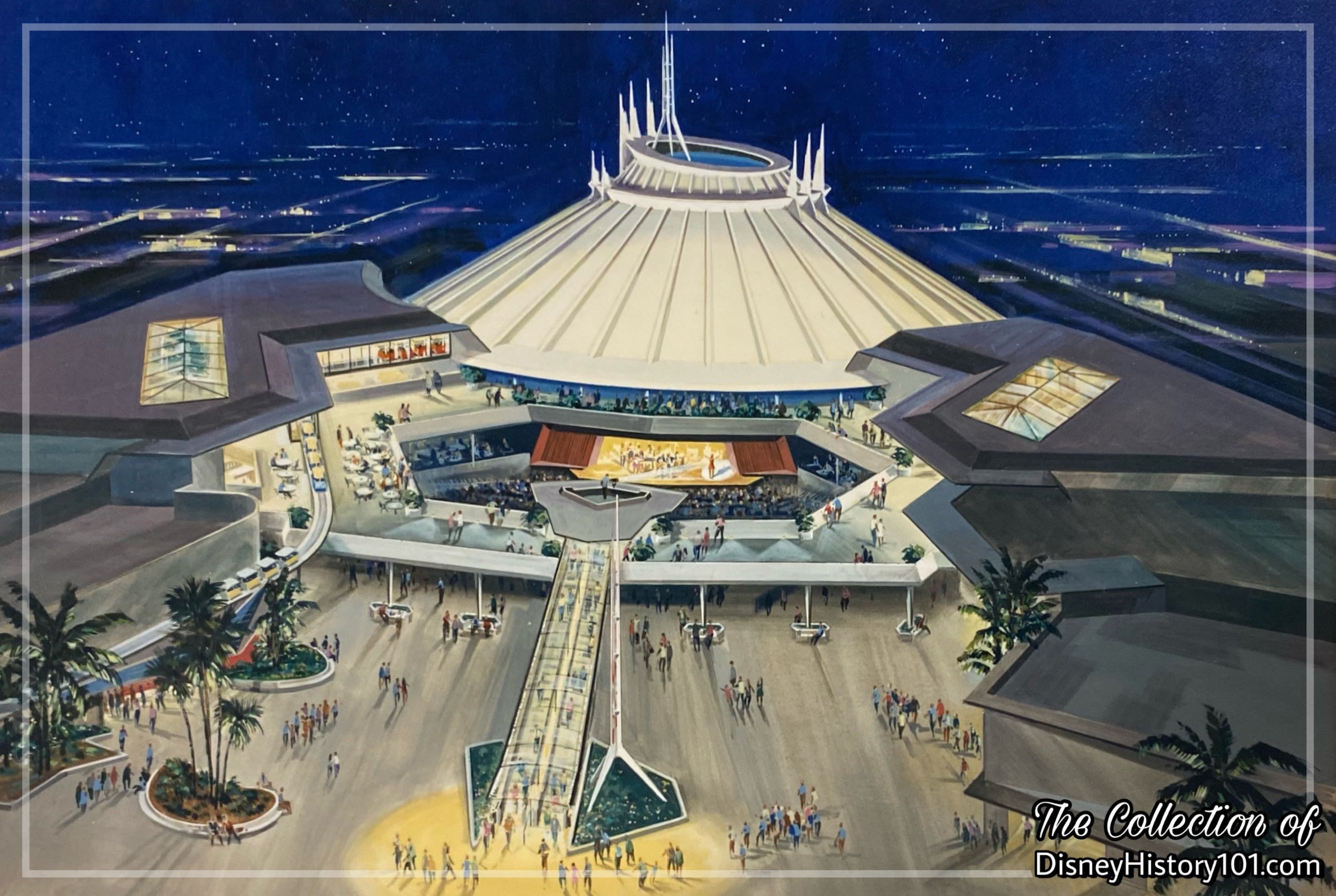
According to LINE Magazine, “John remembers his first meeting with Walt about the project in late 1964. ‘Walt didn’t call it Space Mountain at that time but he felt we needed an attraction in Tomorrowland that would present the future through space travel. Walt had a prophetic ability and knowledge of how to bring different experiences together in a perfect blend…and he knew Space Mountain would be attraction that would serve to enrich the guest’s experience one step further.’” Space Mountain was likely one of several attractions that Walt had in mind when mentioning he had ”plans afoot - some on the drawing board or in model form, others only in the ‘dreaming’ stage…to be added through the year 1980.” [“Walt Tells Problems Studied for New Disneylands,” by Ted Thackery Jr., published Thursday, February 11, 1965, for the Herald Examiner of Los Angeles, California.]
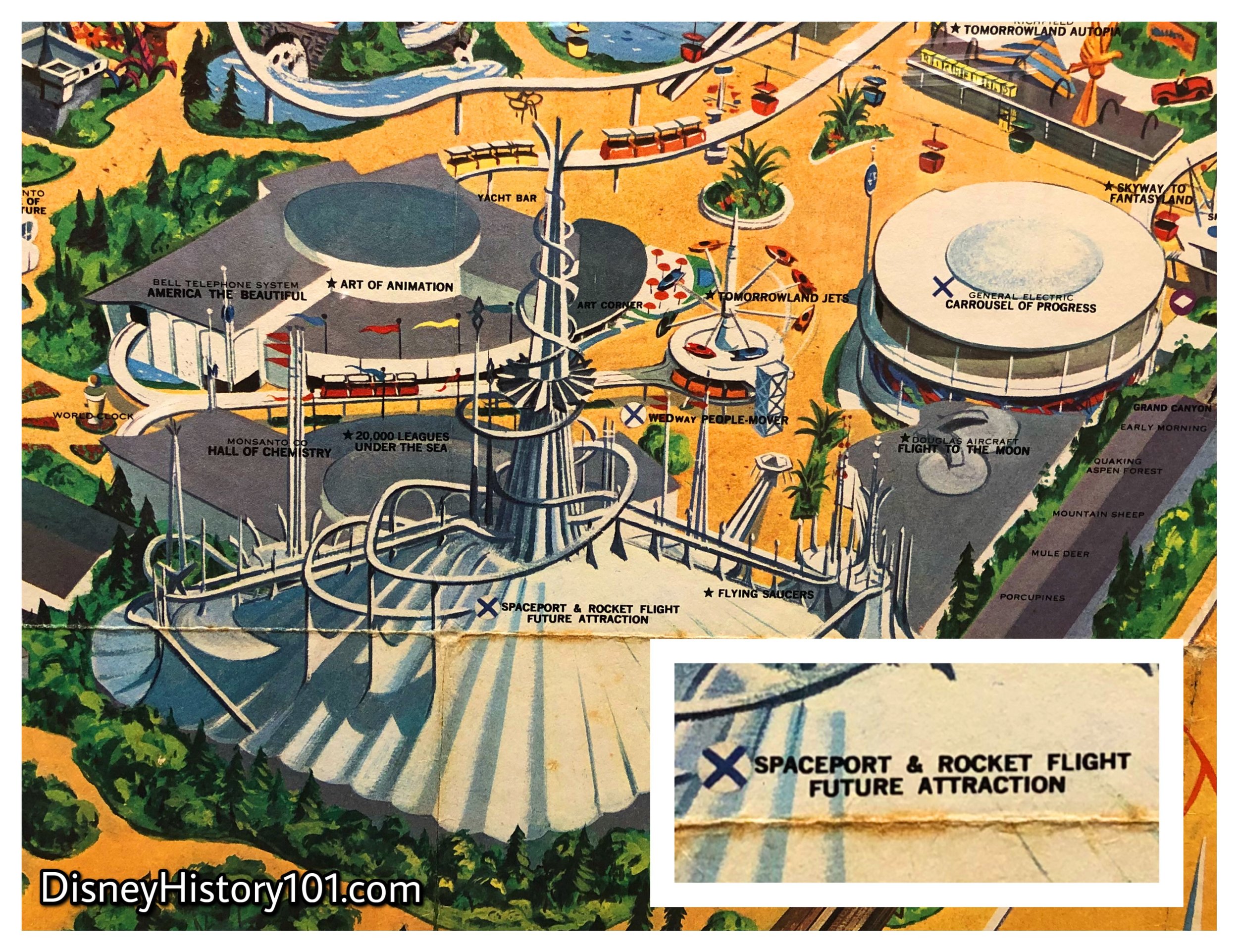
Early concepts featured four “tracks” (some of which wove inside and outside of the Show Building), complete with “soaring spires” (borrowing some style from Herb Ryman’s c.1964 “suggestions” for the New Tomorrowland). About the years 1965 to 1966, the job of “Space Ride R & D” (No. 034-53-22) was opened at WED Enterprises, Inc. Project 034-53-22 was described as Research & Design of a “Matterhorn-type ride with a structure housing four separate loading areas and ride tracks.”
According to “Progressland at Disneyland: a proposal for the General Electric Company from Walt Disney Productions” ©1965: “The word for 1967 is Tomorrowland -a New Tomorrowland. When the present Tomorrowland was designed, in the early 1950's, Early Bird, Gemini and Apollo were space age terms of the distant future. Even the household word ‘astronaut’ was still to be coined. Times-and-tomorrows have changed. So recently Walt Disney and his creative staff have taken a new look at the Tomorrowland area. To research ideas. Walt and his team visited Houston, Huntsville and Cape Kennedy, discussing the latest Space Age wonders with astronauts and scientists, including Dr. Wernher Von Braun. The result: a decision to close the entire Tomorrowland section of Disneyland in the Fall of 1966 for complete redevelopment - the re-building and enlarging of an entire area of Disneyland to provide for dramatic and exciting new attractions and exhibits. In New Tomorrowland, a towering structure will serve as spaceport and theme center. Inside, guests will experience the sensation of racing through distant space.“
Internal materials published in 1966 mentioned: “With four maior new attractions nearing completion for summer, 1966, openings at Disneyland, Walt and his staff af WED are looking toward 1967 - 1968.“ By May 25, 1966, an allowance of $150,000 was allocated toward the cost. By October 1, 1966, an actual cost of $119,000 with a write off of $119,000 was pending approval.
According to John Hench (who led the project), even back in 1965, plans called for a two-level building with guests entering from the second level. “Walt had originally thought of having the lifts on the outside”, John recalls, “but we could control the light much better with an enclosed structure.” Testifying to this is image of this design can be seen in the pages of “A World of Smiles” (the Tencennial Tour Guide scrapbook). Soon, the “Walt Disney Productions Annual Report to Shareholders and Employees Fiscal Year Ended October 2, 1965” announced: “In New Tomorrowland, a towering structure will serve as a spaceport and theme center. Inside, guests will board four-passenger ‘rocket ships’ to experience the sensation of racing through distant space. Spiraling upwards as high as an 18-story building, the ‘Tomorrowland Mountain’ will be the highest point in the Magic Kingdom, a magnet visible for miles.”
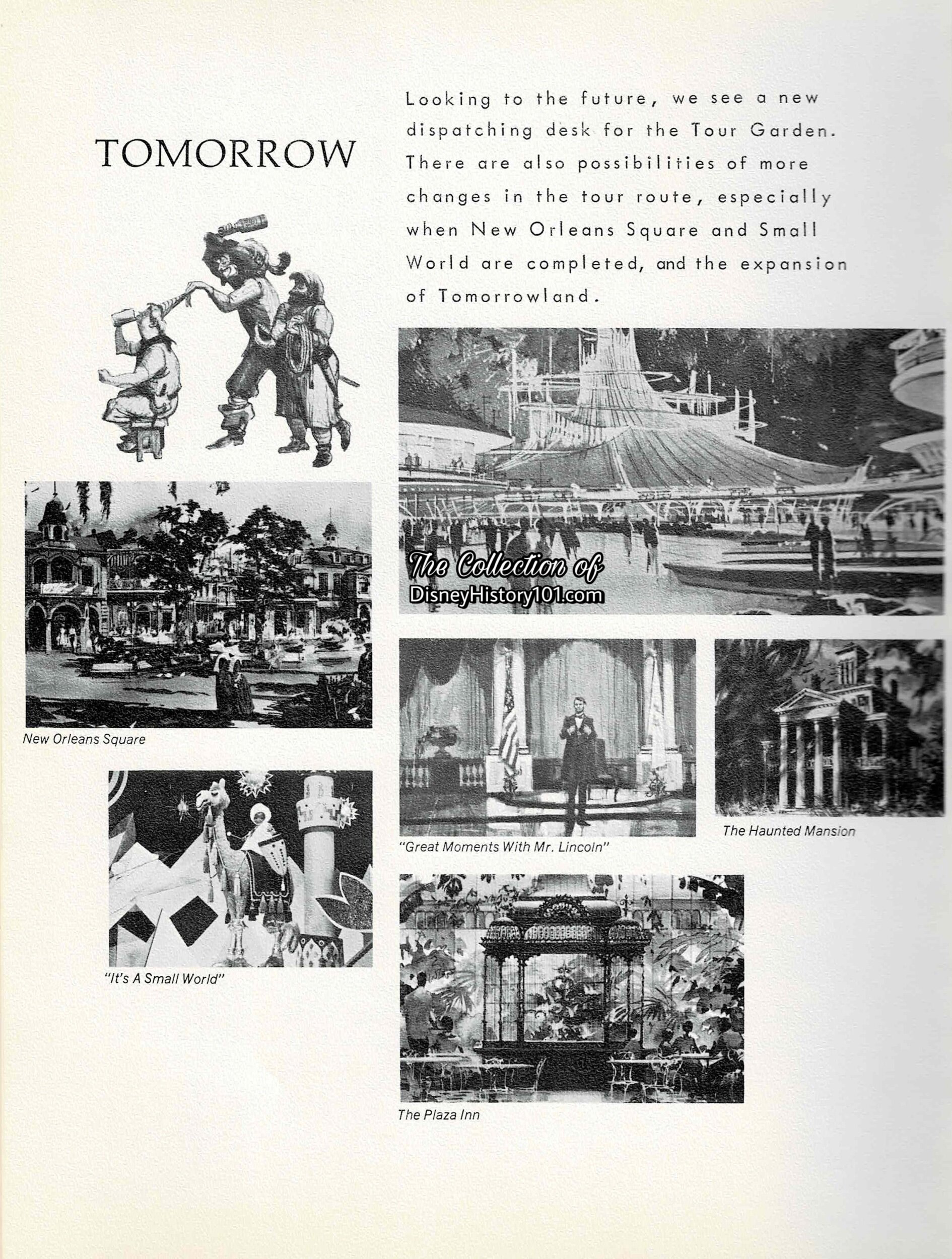
“A ‘Hold’ on Space Mountain, and a ‘Gap’ in Development” - It’s a fact, that the “Space Mountain” name was first attached to the project during 1966. During this time, Herb Ryman produced mode concepts of the spire-topped show building and WED Enterprises, Inc. engineers were utilizing “far-ahead” computers to conduct stress and design analysis (including those of the curves and turns of the track). The layout revolved around utilizing gravity and kinetic energy to keep the cars moving forward. Some of these viable project Concepts (as seen above), were supported by a well-developed business case and built expectation. However, it seemed that there was not the necessary space to house this attraction, as Walt was “running out of building room inside the 20-feet Hugh earthen berm surrounding Disneyland.”
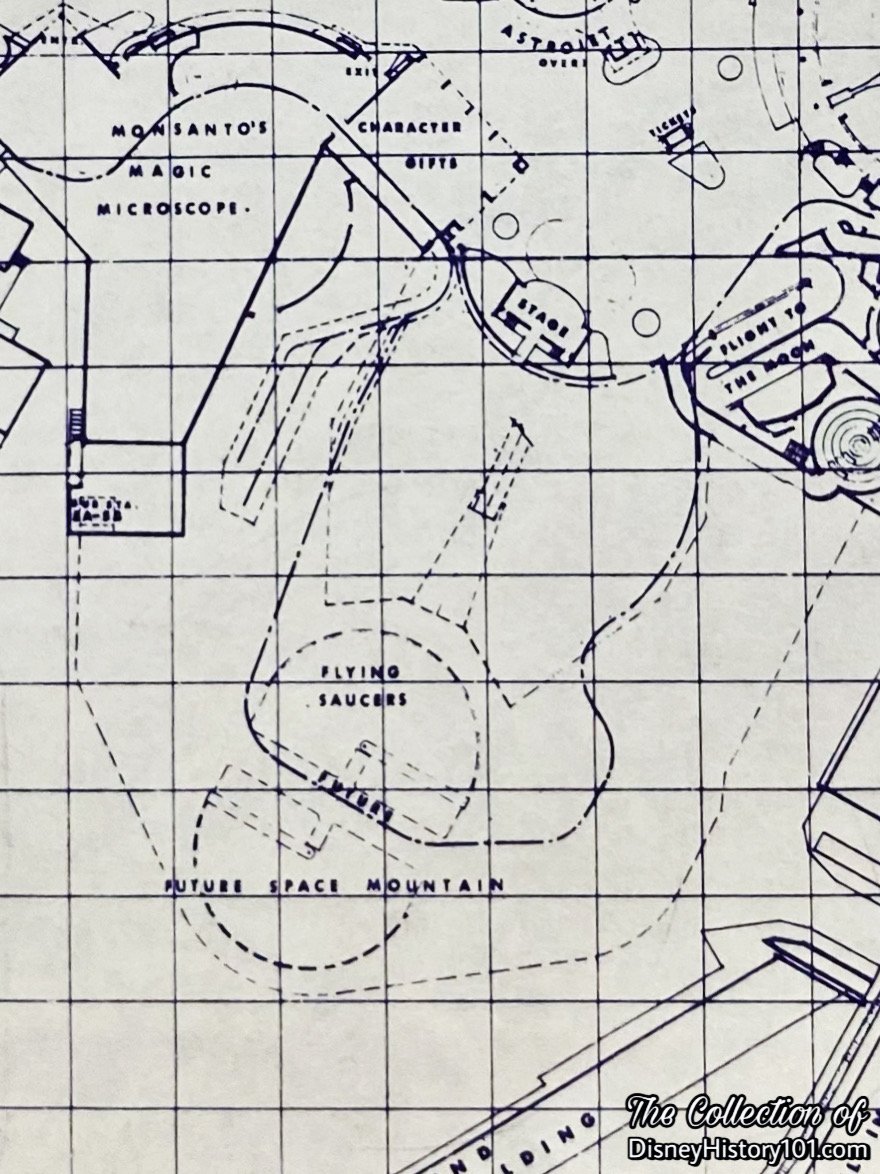
Then there was the matter of the computer technology to control the safety “Block (brake) System.” The Automatic Block System was a series of consecutive blocks governed by block signals that were actuated by a train, engine or by certain conditions affecting the use of a block. The system was used on the Disneyland Railroad but was seemingly limited for application toward Space Mountain. So after Walt’s passing (in December of 1966), any plans for this particular future Disneyland attraction were put on hold while Walt Disney’s Magic Kingdom was brought to reality.
A WED philosophy is that there is no bad idea. “We say that because if you get in a meeting and somebody comes up with something and someone turns to him and says, ‘That's a stupid idea!’ you'll probably never get another idea from that person. So, we try to create an open environment where people can say anything. Quite often, something that sounds dumb at the time will turn out to be just the little spark that sets everything off Somebody will come in later and say, You know, I thought what so and so said was dumb, but I’ve been thinking about it and I think there's a little gem here.’ Its amazing how many times that happens…‘ Marty said that he's been around so long and has discussed so many ideas that he has seen many resurface after many years. ‘When that happens, I know from experience that a lot of them won't work, but I don't say, 'Well, you know what? We tried that 20 years ago and it won't work; because so much changes. If we went back through our archives, we'd probably find a lot of things that we could do today that we couldn't do at the time because the technology wasn't there.’“ [“Ripley’s Legends - pioneers of the Amusement Park Industry” by Tim O’Brien, Volume One]
Walt once said: “Since my outlook and attitudes are ingrained throughout our organization, all our people have this curiosity; it keeps us moving forward, exploring, experimenting, and opening new doors.” So began the blending of creative and technological innovation with the essence of great Disney storytelling. Soon, one of the Magic Kingdom’s planned adventures included the “Space Voyage” - the first incarnation of Space Mountain! Four years later (and by the early 1970s), true-life space-age computer technology had advanced enough to control the proposed safety “Block System” enabling multiple cars to safely run along the rails simultaneously. In fact, the block system was controlled with the help of two Data General Nova 2/10 computers. Sensors (electronic elements in the track) monitored the speed and spacing of vehicles.
So, the plans (employing research, development, and conceptual artwork of John, George, and Herb) were “dusted off” by the WED Creative Development Division members. New concept art was created by artists like Walt Disney Imagineer Clem Hall (c.1974). New software from NASA was utilized to design the support structure and required specs of the attraction. Though the original four “track” concept was reduced to two “tracks” and the attraction would be fully-enclosed in the Show Building (design by WED Enterprises Imagineering Project Engineers Glenn Durflinger, Bud Stacy and Randy Carter), the attraction would make use of the old c. 1966 working title.
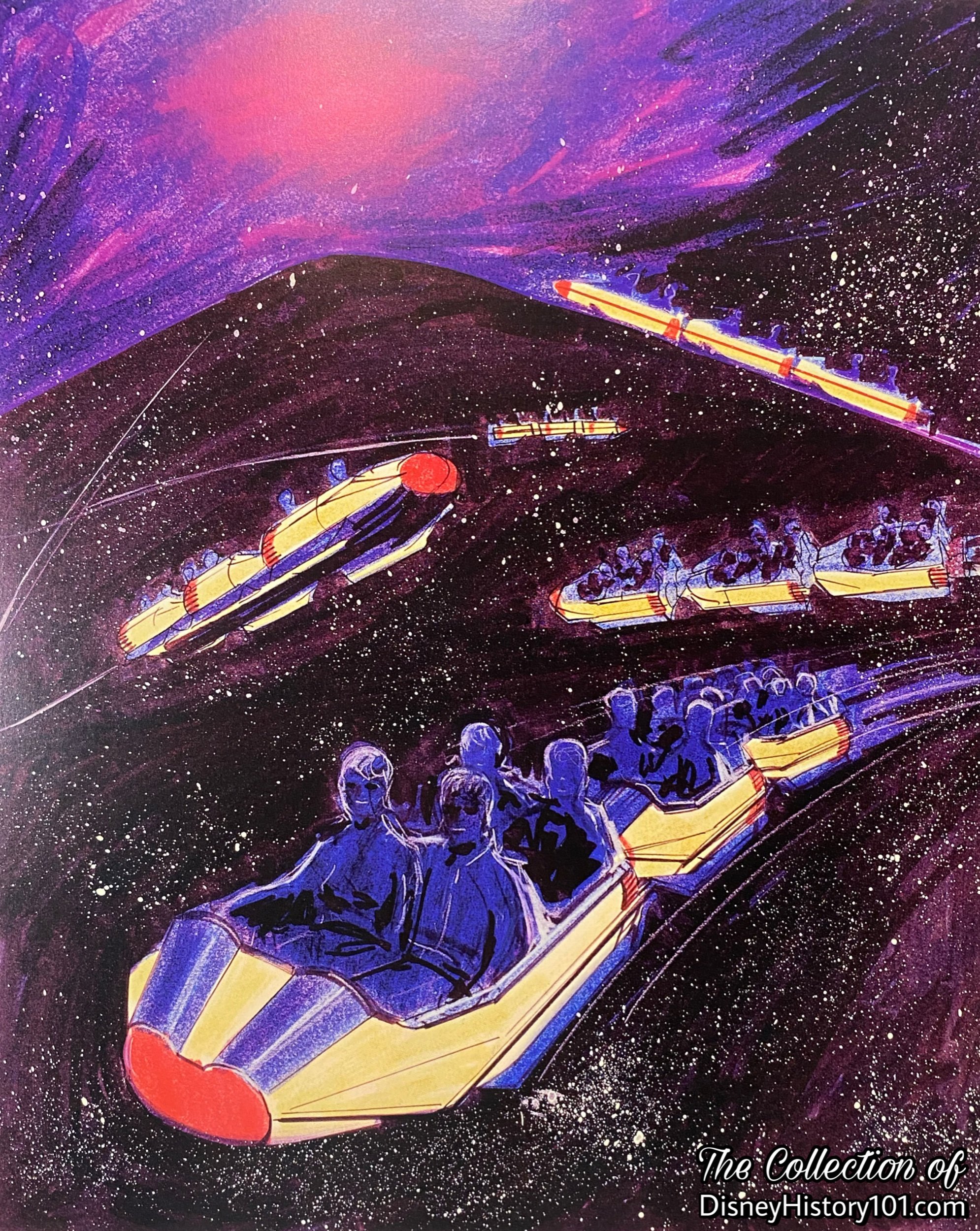
True life astronauts Gordon Cooper (of the Mercury 9 & Gemini 5), James Irwin (of the Apollo 15), and Scott Carpenter (of the Mercury 7) helped open Space Mountain at Walt Disney’s Magic Kingdom, on January 15th, 1975. Space Mountain was a grand success.
Meanwhile, Disneyland had managed to “maintain its levels of attendance in the face of rapidly expanding competition for California's leisure dollar, and despite the fact that the Park has not opened a major new area since Bear Country in early 1972.” As approximately 60% of the Park's attendance came from within the state of California, “new attractions remained a vital factor in stimulating repeat visits and assuring the Park's continued future growth. Therefore, in 1975, the Company committed itself to a major new capital development program for Disneyland.” By September of 1975, construction crews received the “All Clear” (under the supervision of Maintenance Lead Bud Poole) to begin work on the second incarnation of Space Mountain, and Disneyland's second “mountain.” Construction commenced during September of 1975.
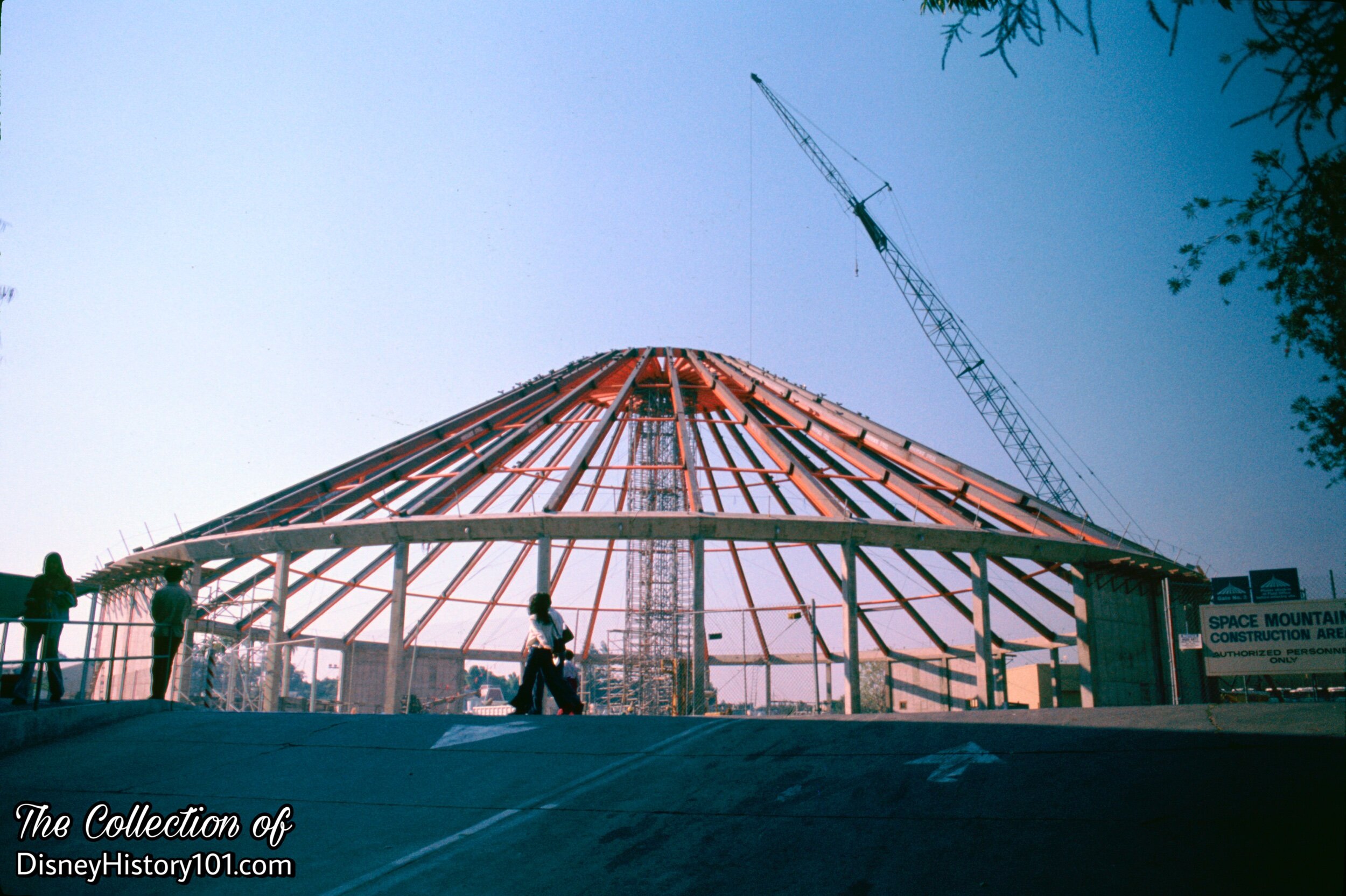
The steel frame of the Space Mountain show building is 200 feet in diameter, holding more than 1 million cubic feet of space. It is hard to see from this “Vintage View”, that the base of the structure is set 17 feet below grade (or, ground level). A considerable portion of Space Mountain was placed below the ground level in order to reduce the height visually in relation to the smaller Sleeping Beauty Castle. From ground-level, the structure would measure 75 feet tall not including the spires. If Imagineers did not scale down and sink part of Space Mountain deep into the earth it would have become a Visual Intrusion and a contradiction, dwarfing Sleeping Beauty Castle and all of Main Street.
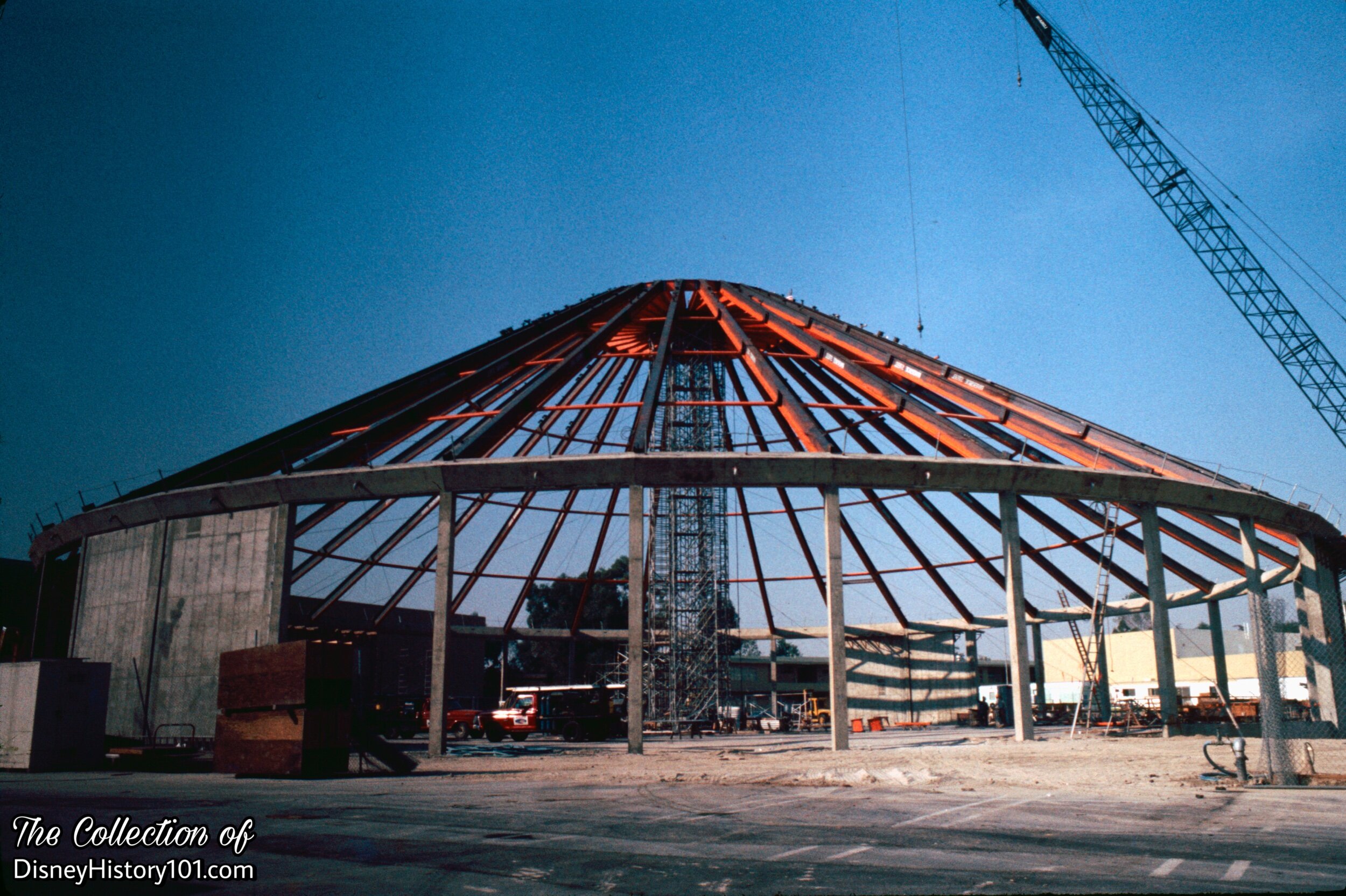
There are a total of thirty-six steel support beams atop forty-five concrete pilings.
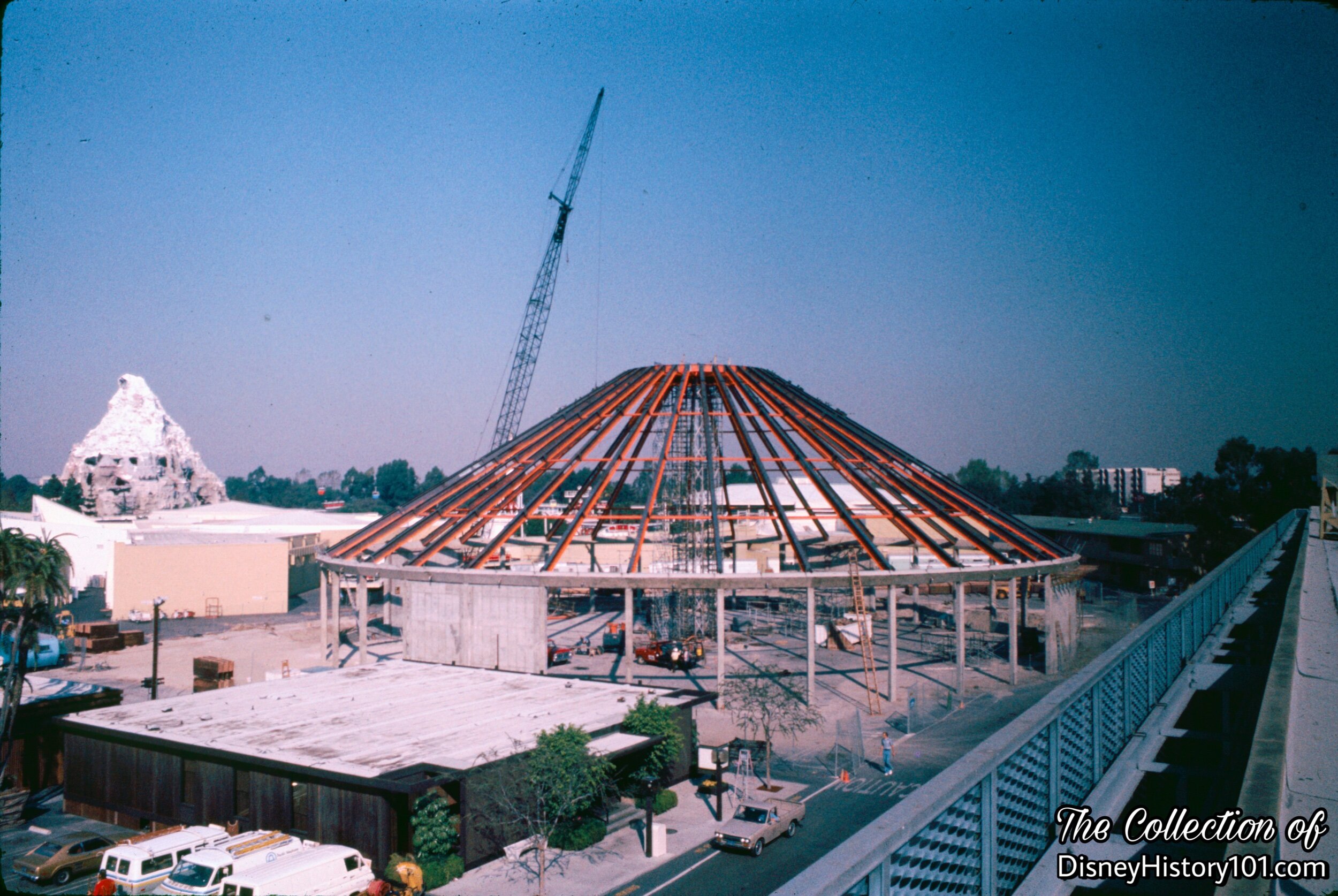
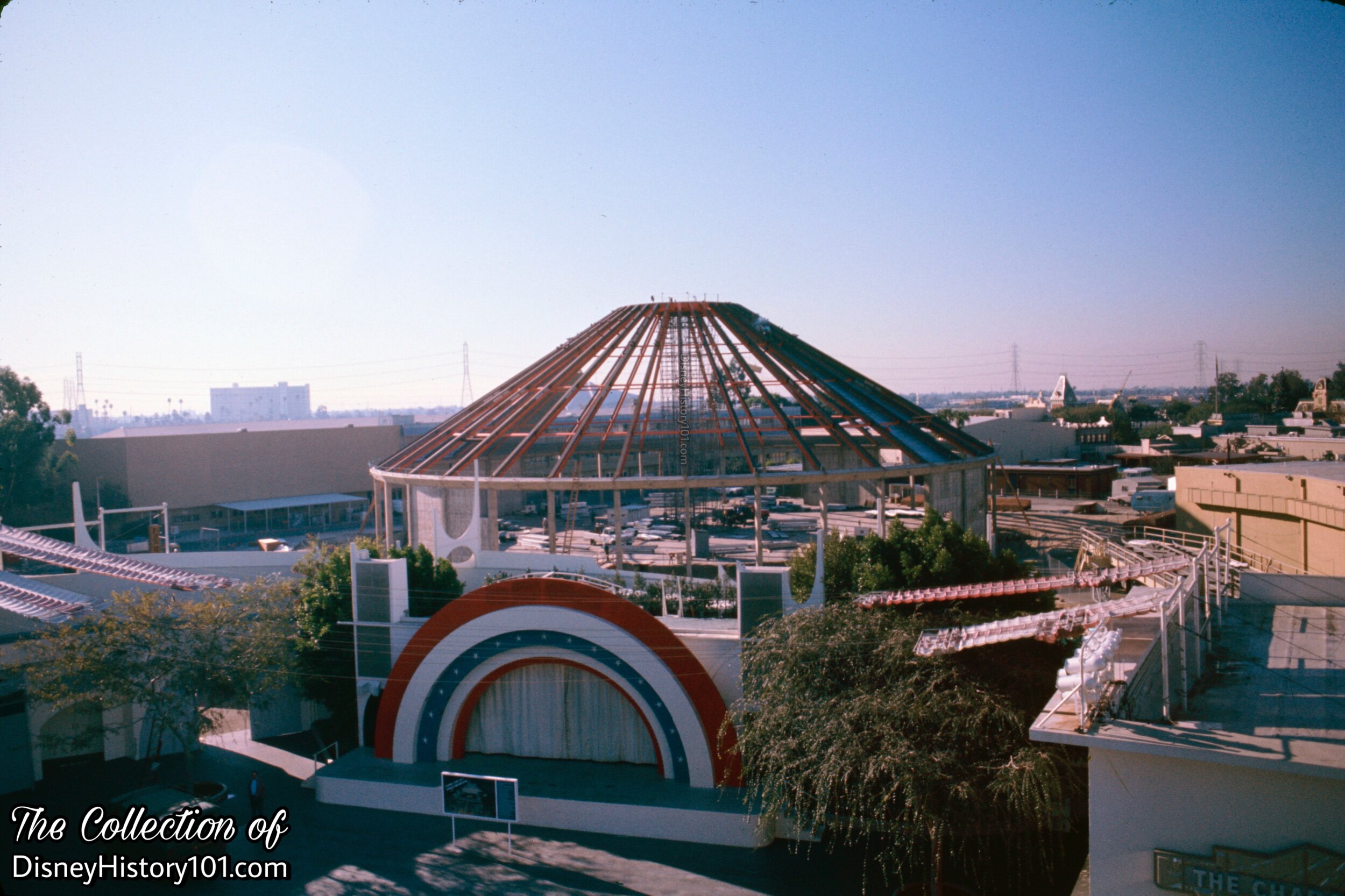
Before the 1,100 seat Space Stage was installed in front of the Space Mountain Complex, this was the look of its facade and the Tomorrowland Stage.
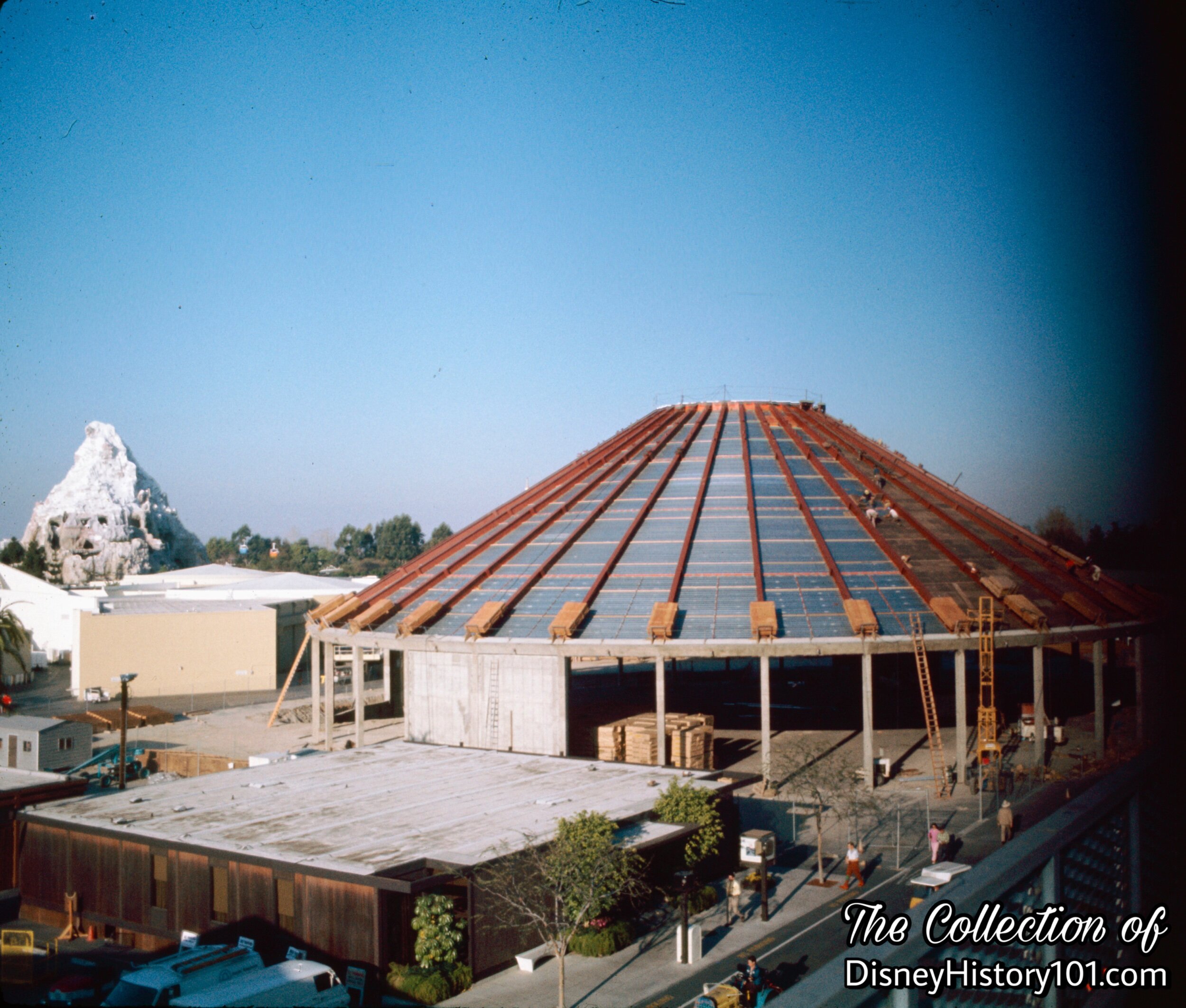
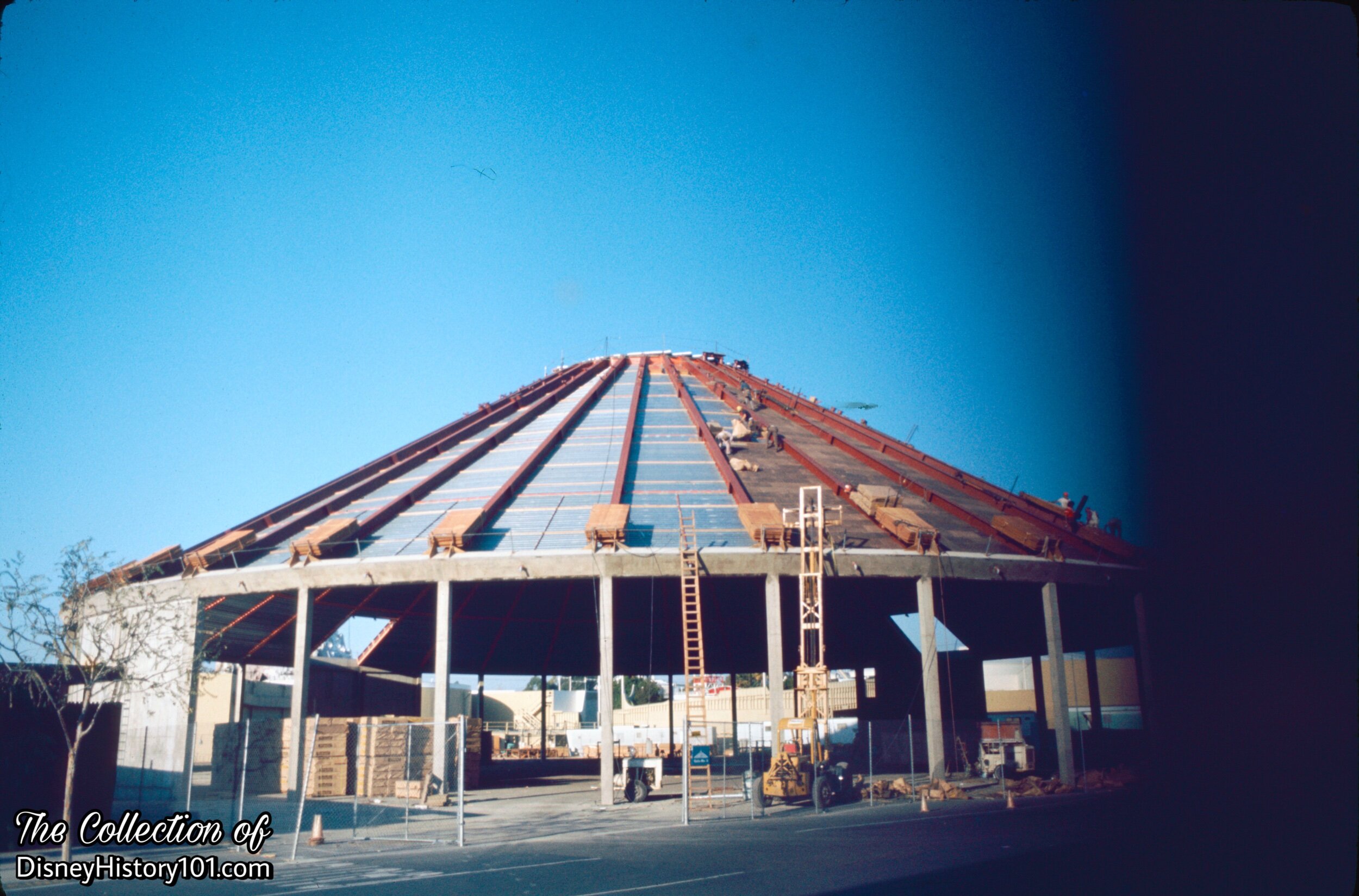
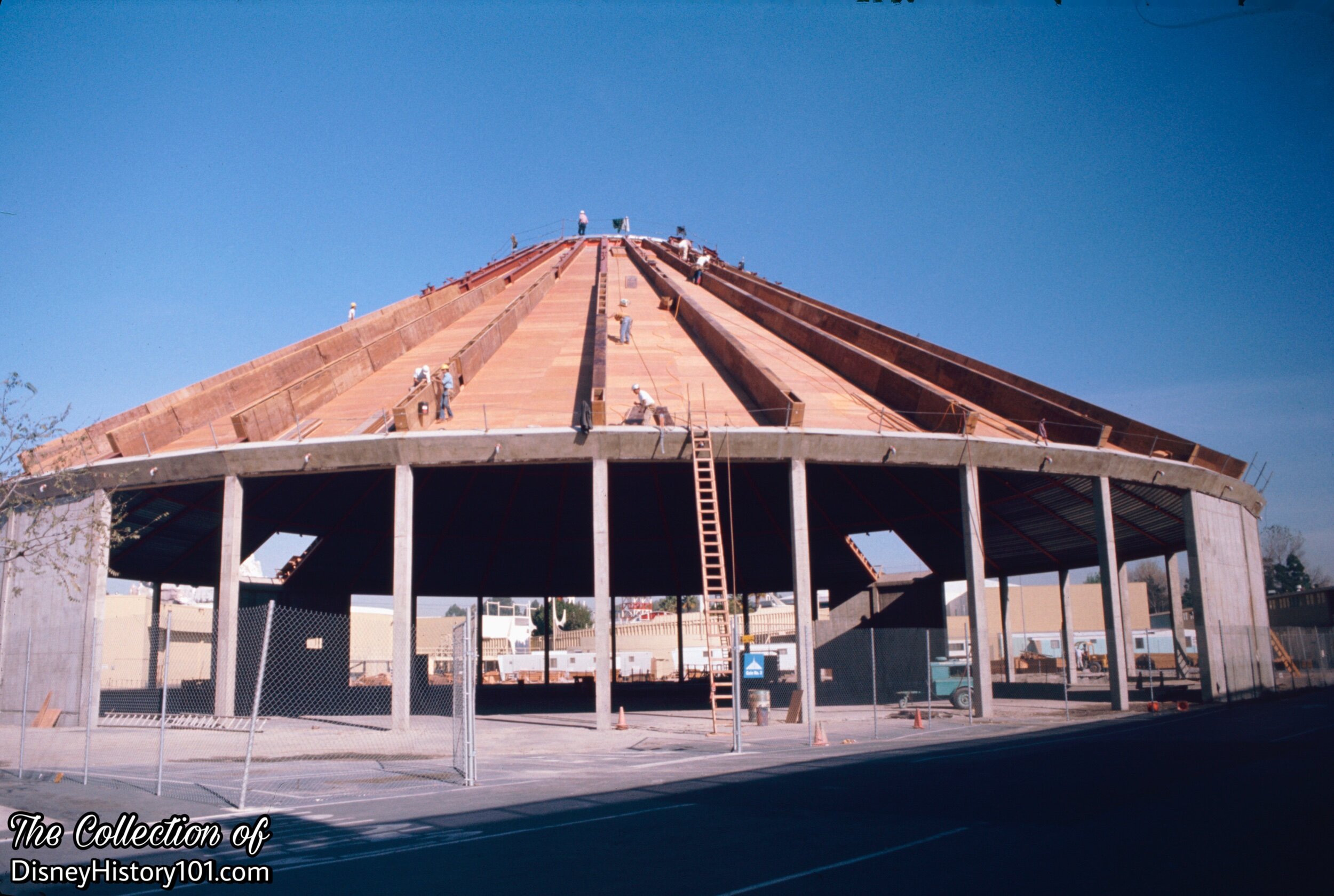
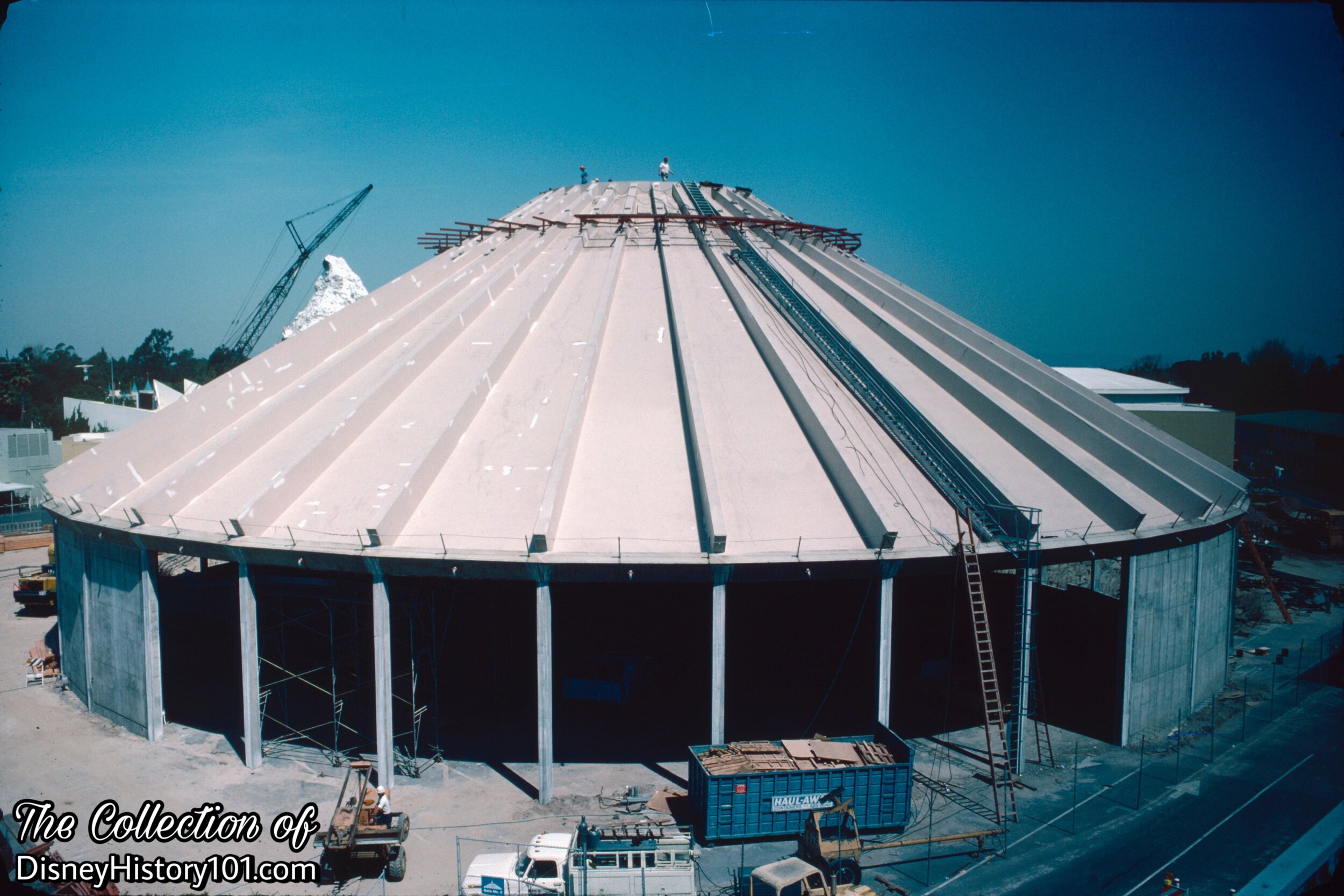
The show building was 75 feet tall (without the external spires).
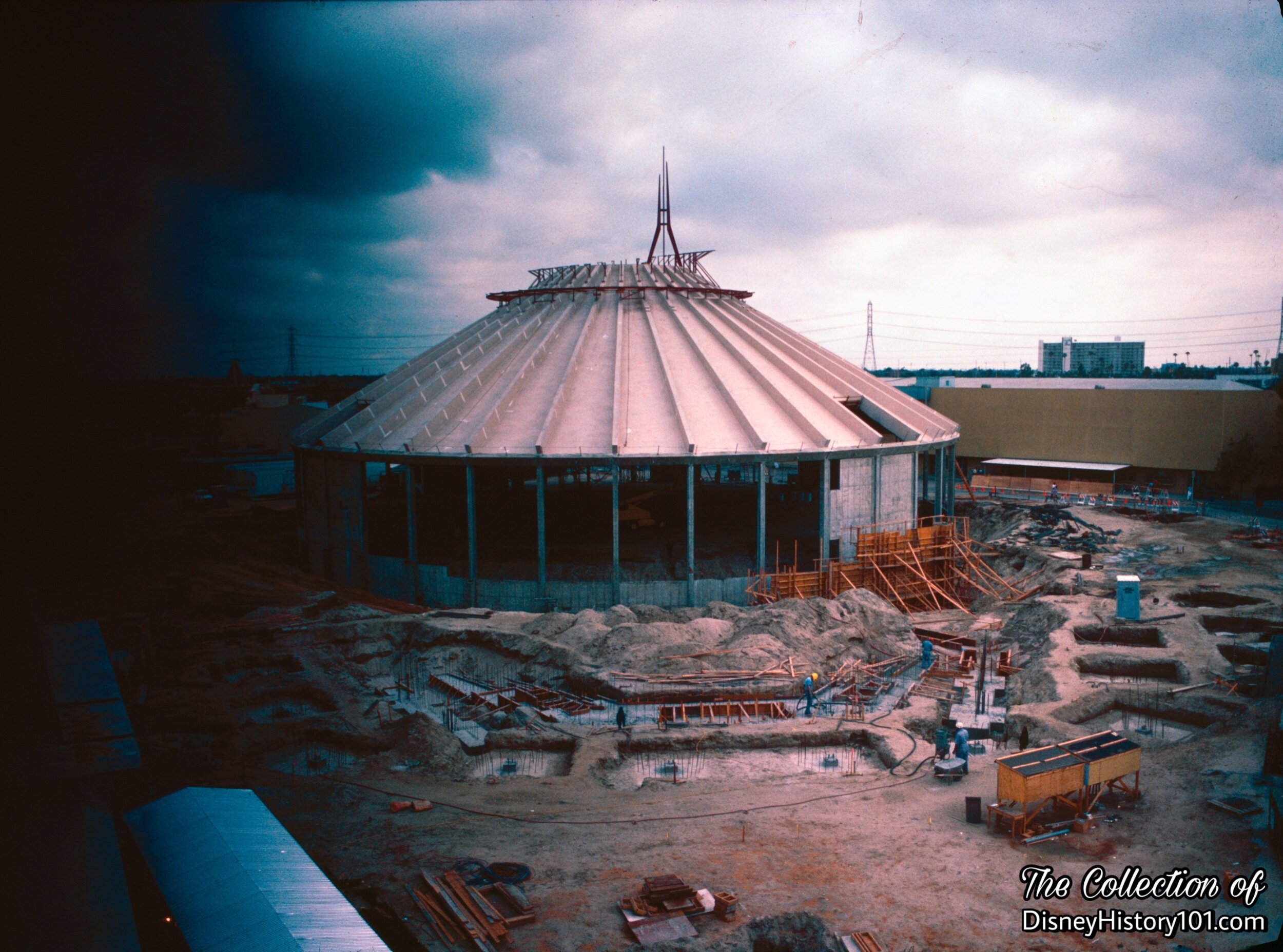
But it was 117 feet from the ground to the top of the tallest spire point.

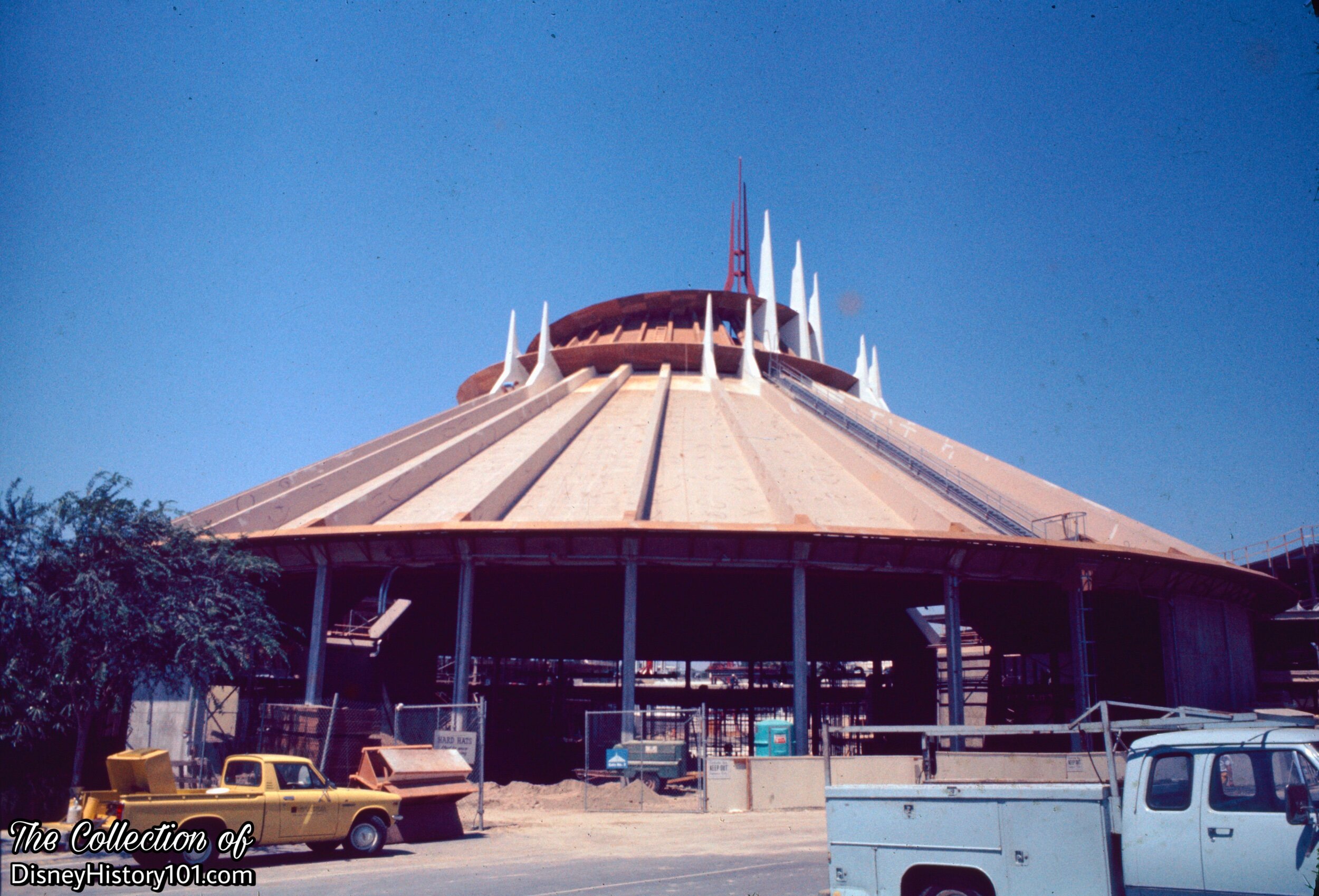
The show building would measure 117 feet from ground-level to the top of the tallest spire.
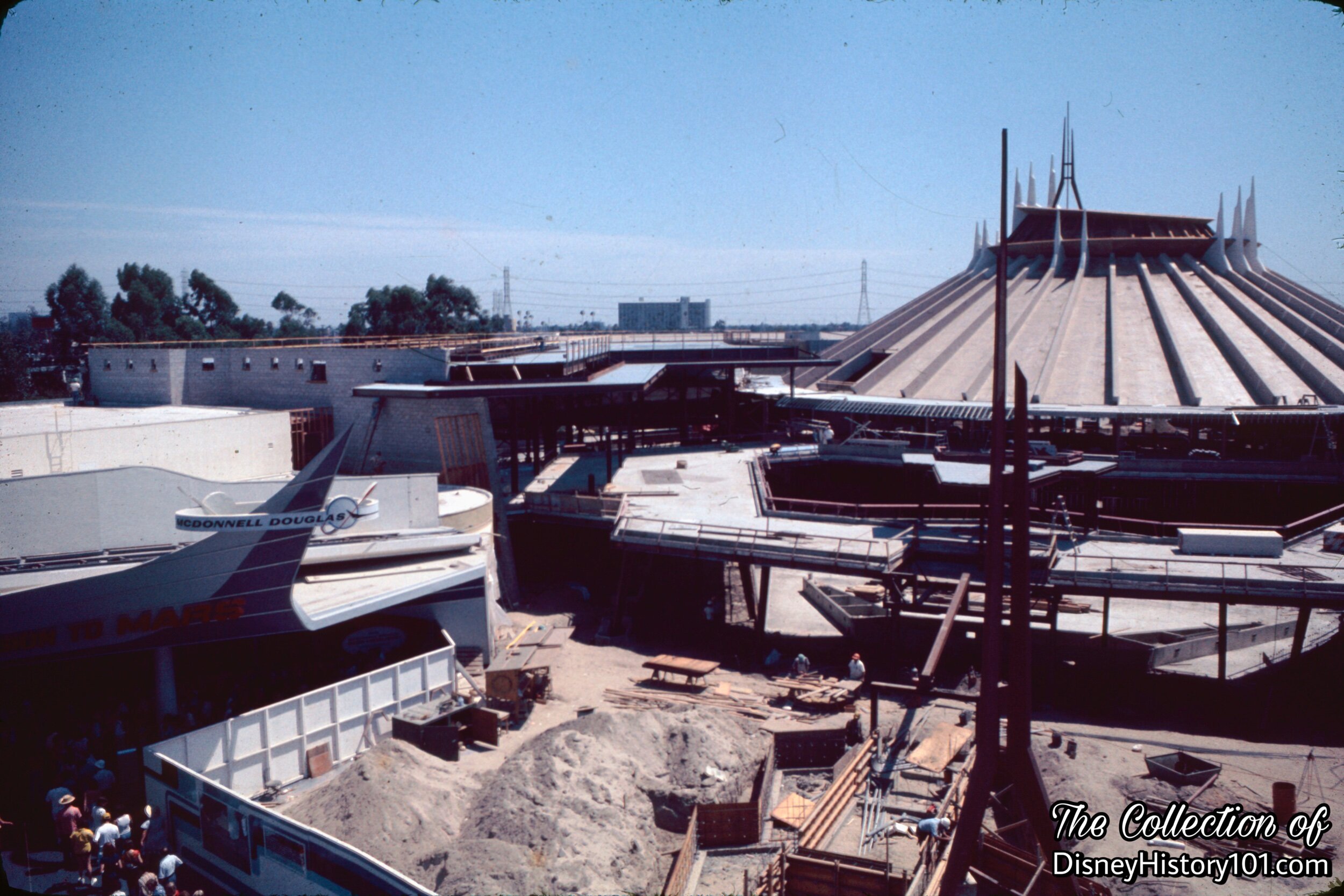
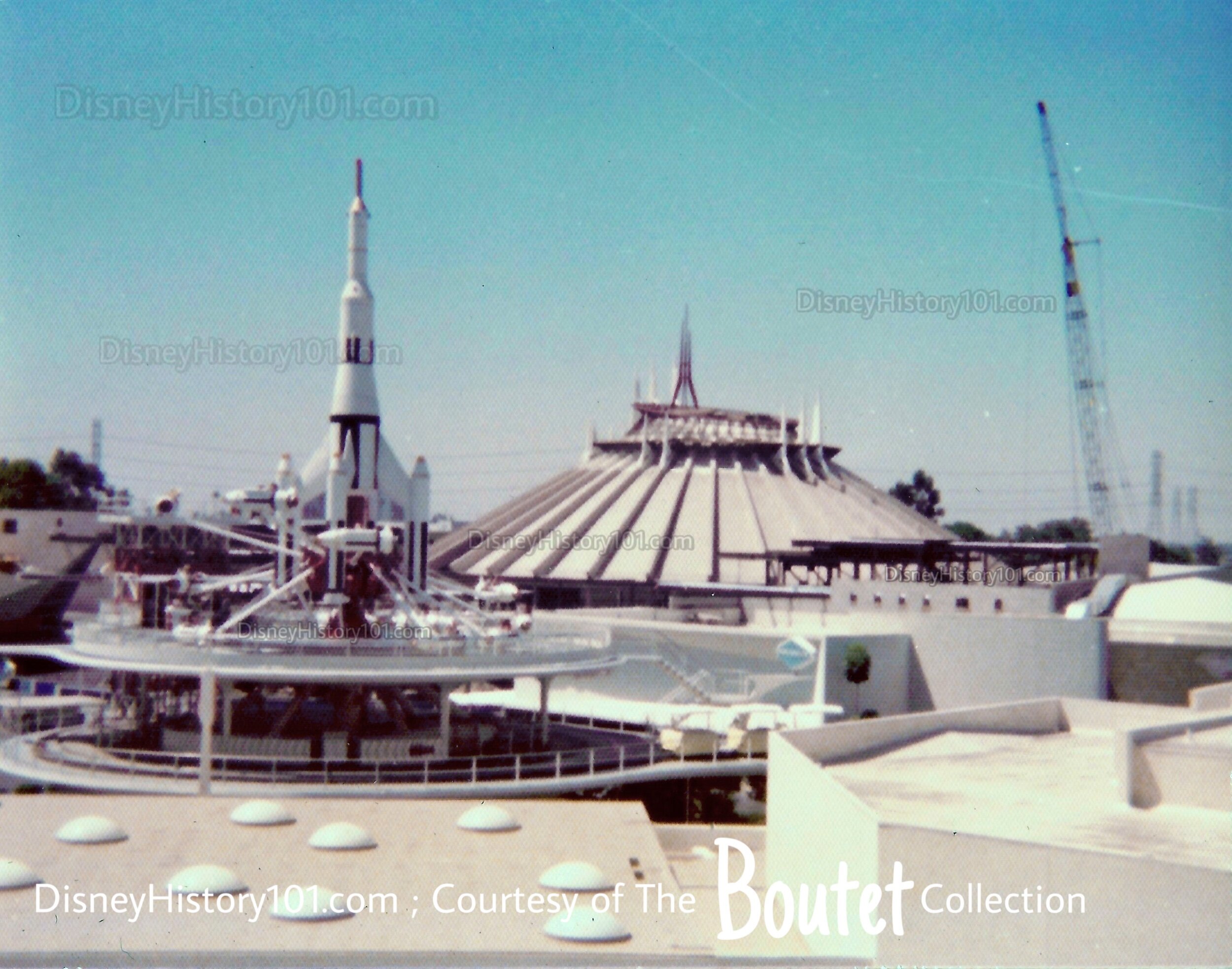
While the tubular steel track layout of the Matterhorn Bobsleds was installed before much of the wood frame and stucco was applied, the Space Mountain show building exterior was enclosed before the steel track was laid. The length of the competed ride track was 3,035 feet, (not including the spur track, and storage track, which brought the approximate total to 3,450 feet). Soon, one Program Logic Controller (PLC) system and a Nova system (“for message generation” and alerting operators and engineers to any conditions of units) was installed. These were similar to those first installed at Walt Disney’s Magic Kingdom in Florida.
Plans for the majestic Space Mountain Show Building were still being approved by February of 1975. But as soon as construction began, LINE magazine often published the “Space Mountain Update”, to educate Cast Members on the progress of the attraction.
For instance :
•Saturday, March 5, 1977 : 2400 pounds of sand was cycled through the Mountain to evaluate structural aspects of the attraction.
•By March 10, 1977 Disneyland LINE reported : “The Spaceport Load/Unload Area construction is progressing rapidly an assembly has started on the Intergalactic Probe. All attraction control equipment has been delivered and installed, and initial ride control testing will begin [during the remairing days - March, 10th-12th] this week. All catwalks along the track have been installed. Installment of the five speed ramps is currently in progress. Regrading of the area in front of Mission to Mars was started this week. Regrading is necessary for a smooth thematic transition into the new Space Mountain complex.”
Air-conditioning controls dust, and a practical mechanical application of the technology was essential in the attraction where projection equipment and film was used.
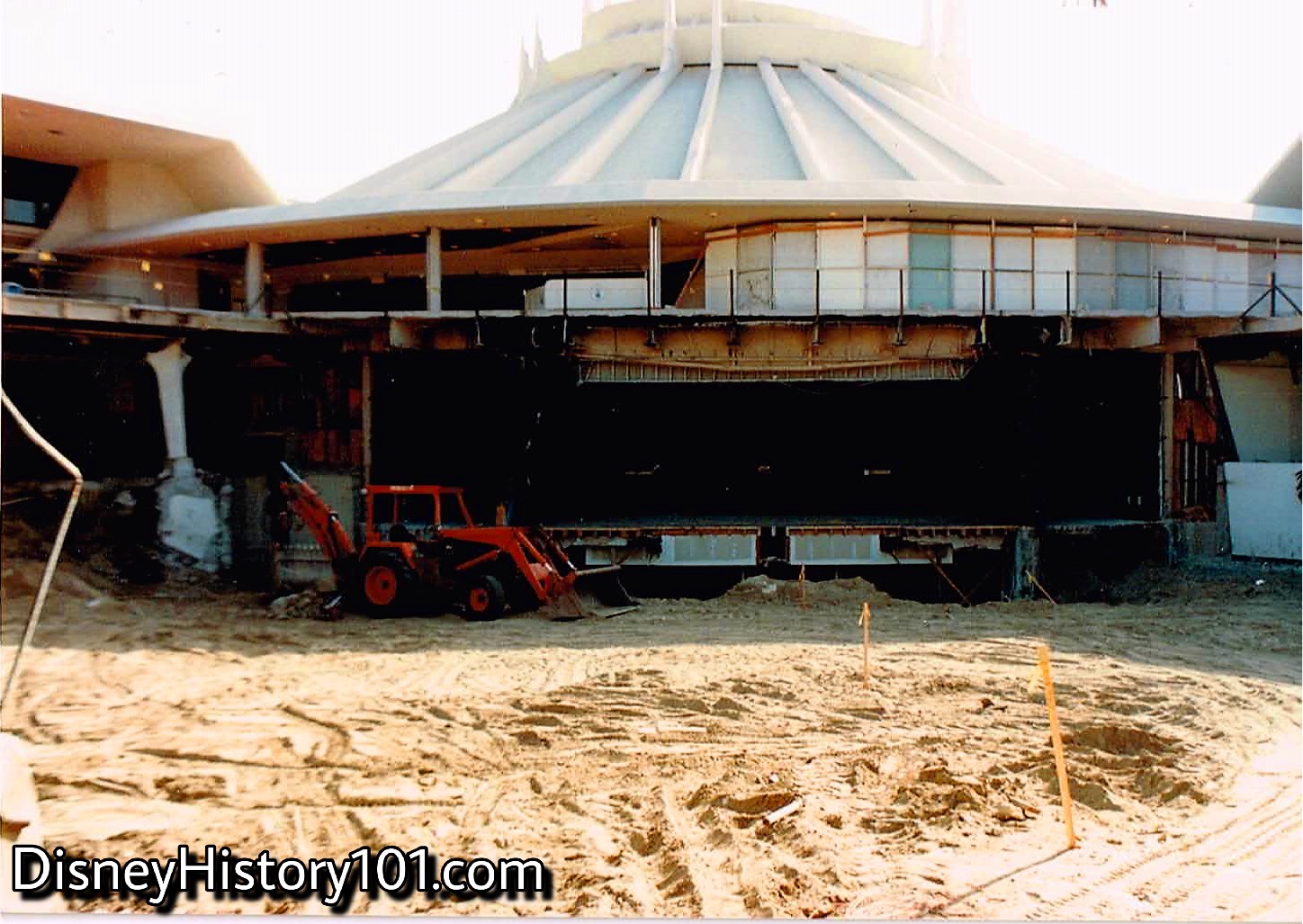
The lower areas of the Space Mountain Complex will house a modern arcade, a merchandising shop, a fast food facility, and a large amphitheater for live entertainment.
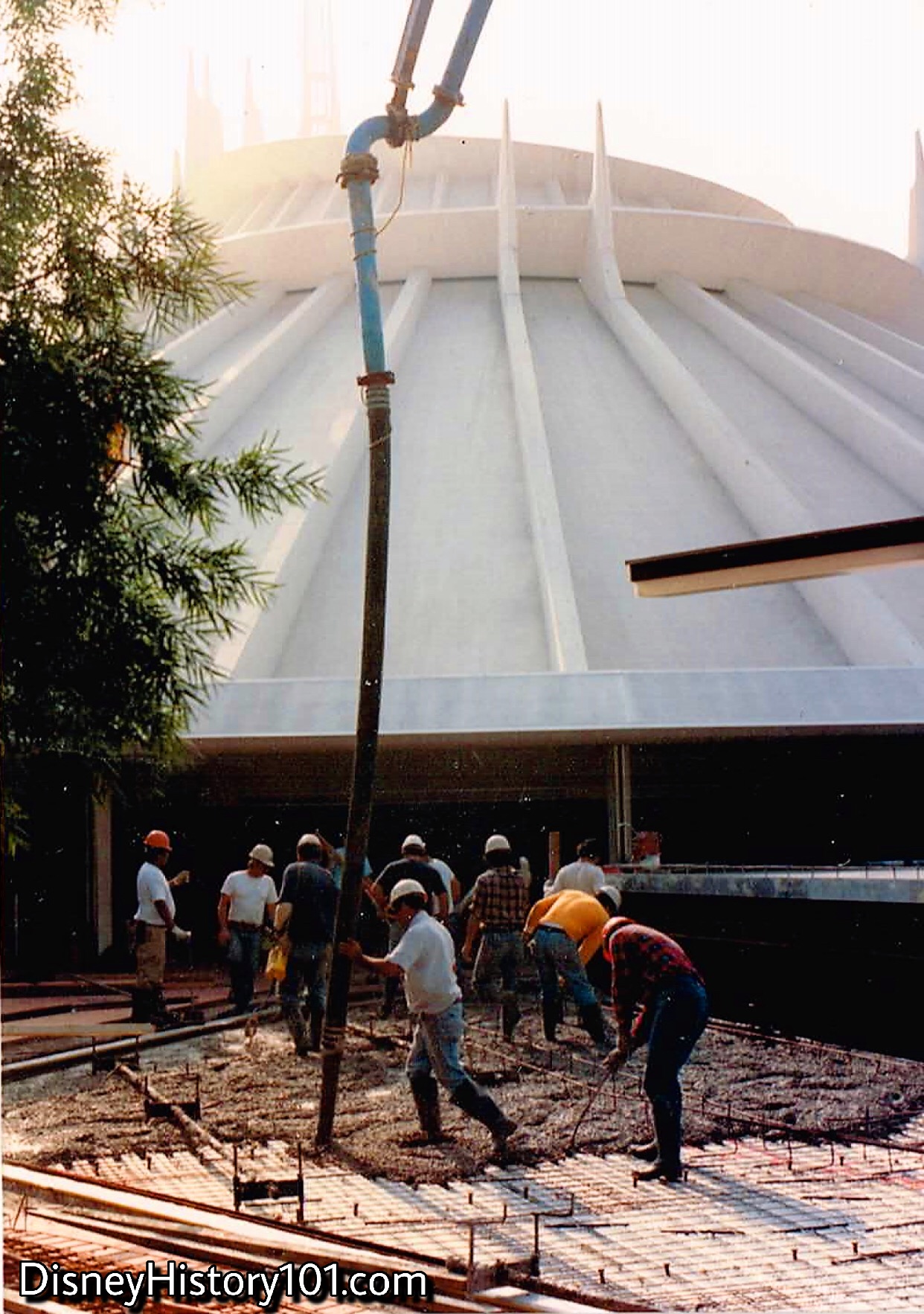
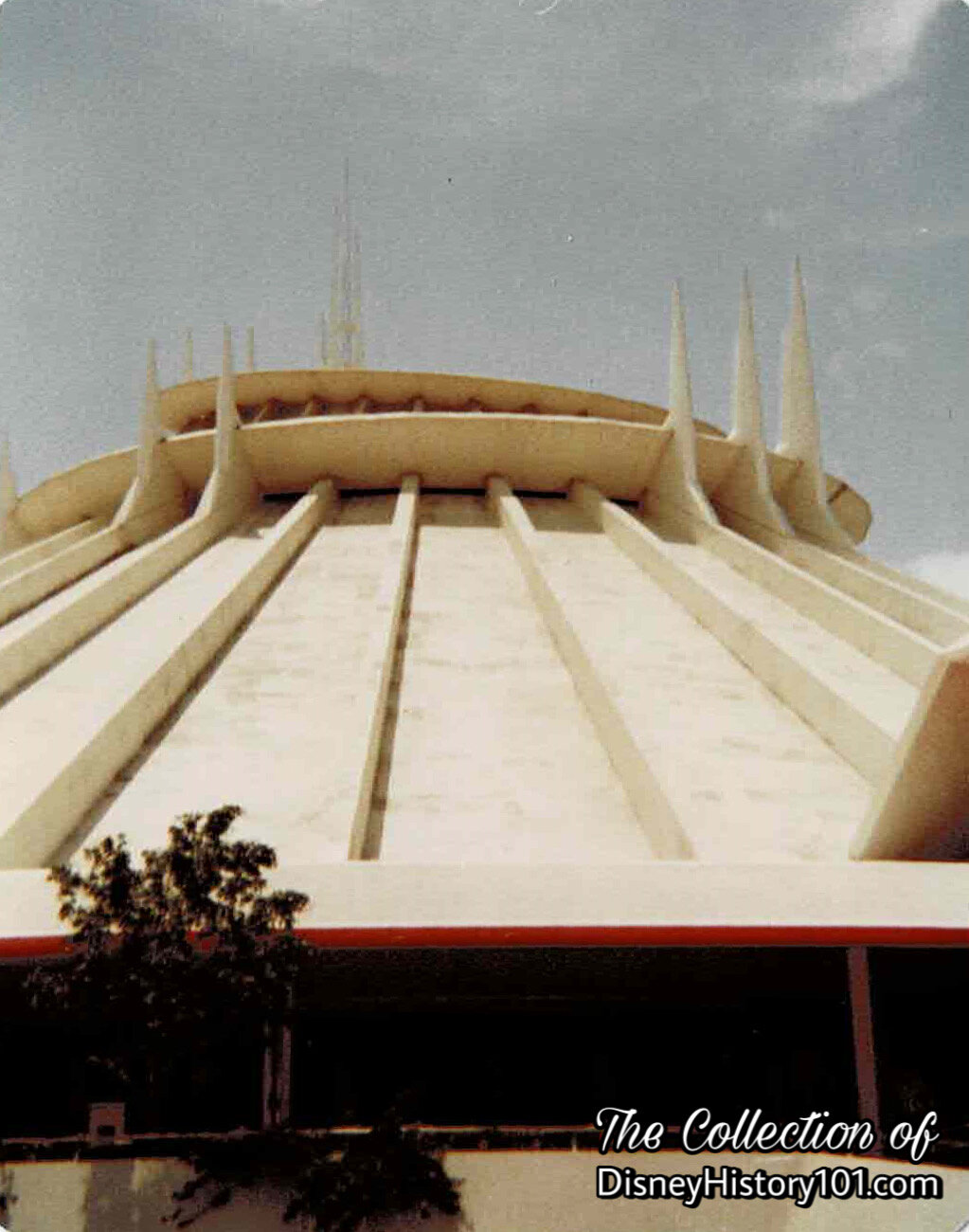
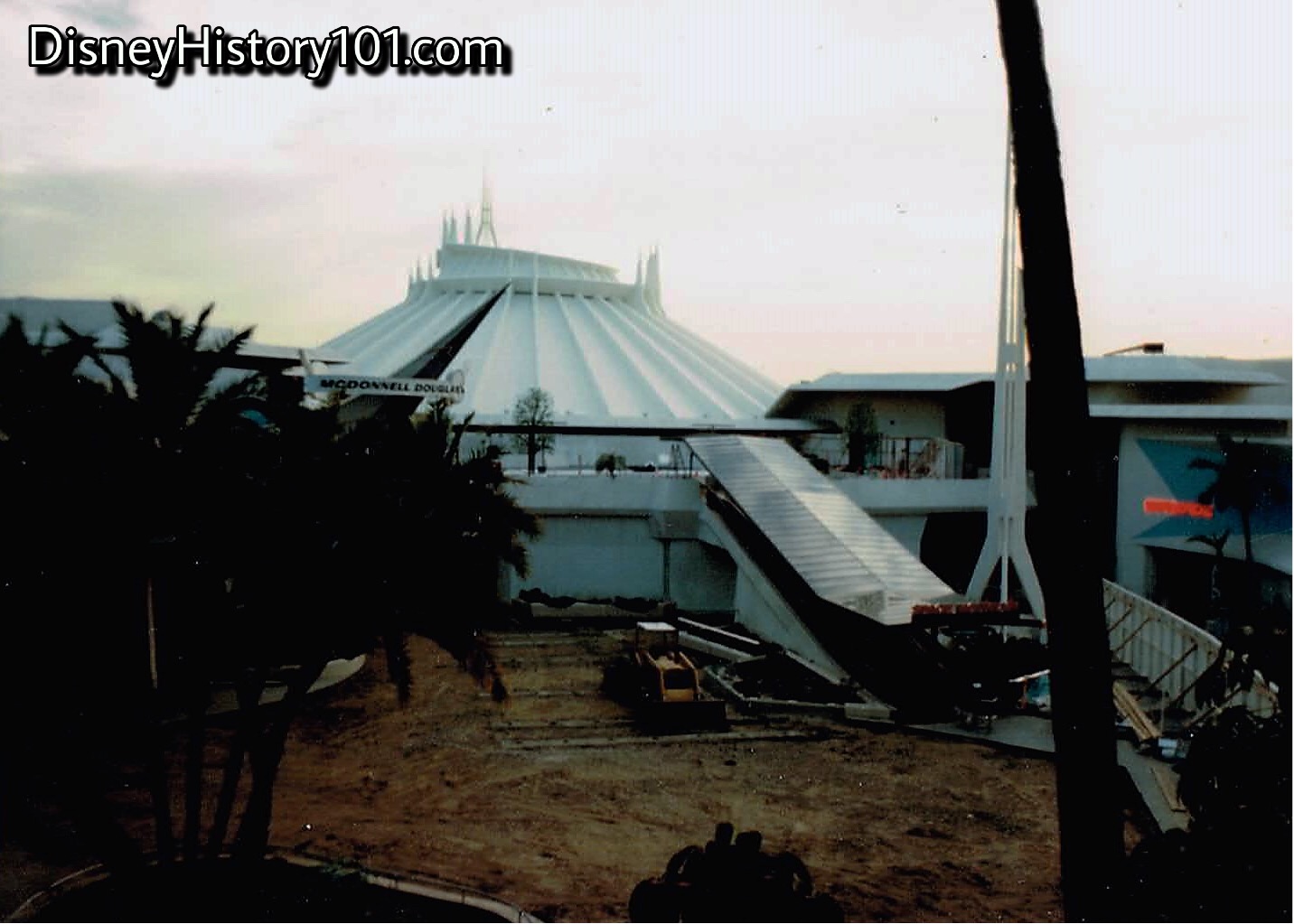
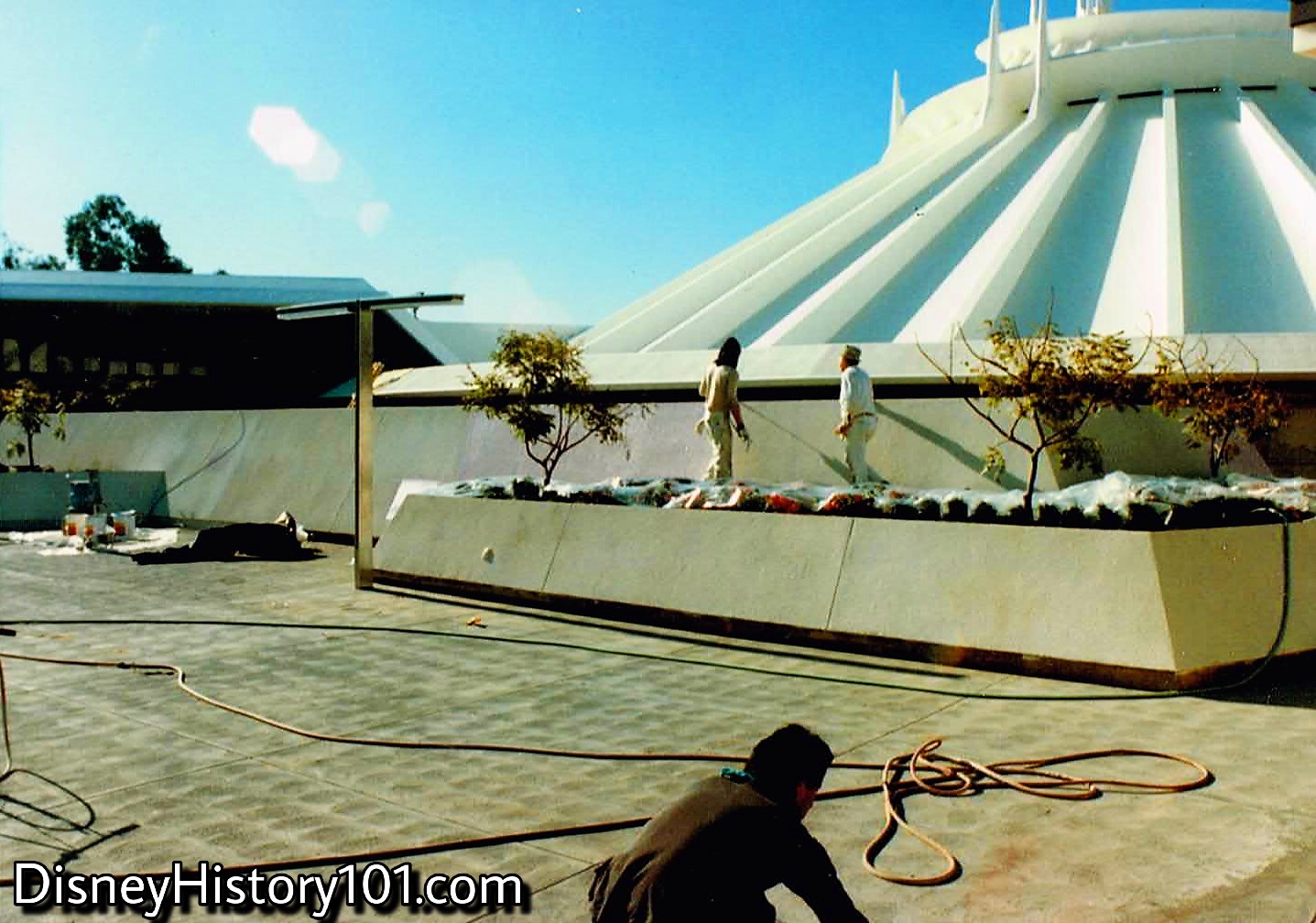
This is where Guests will wait in an orderly fashion (queue) to board Space Mountain.
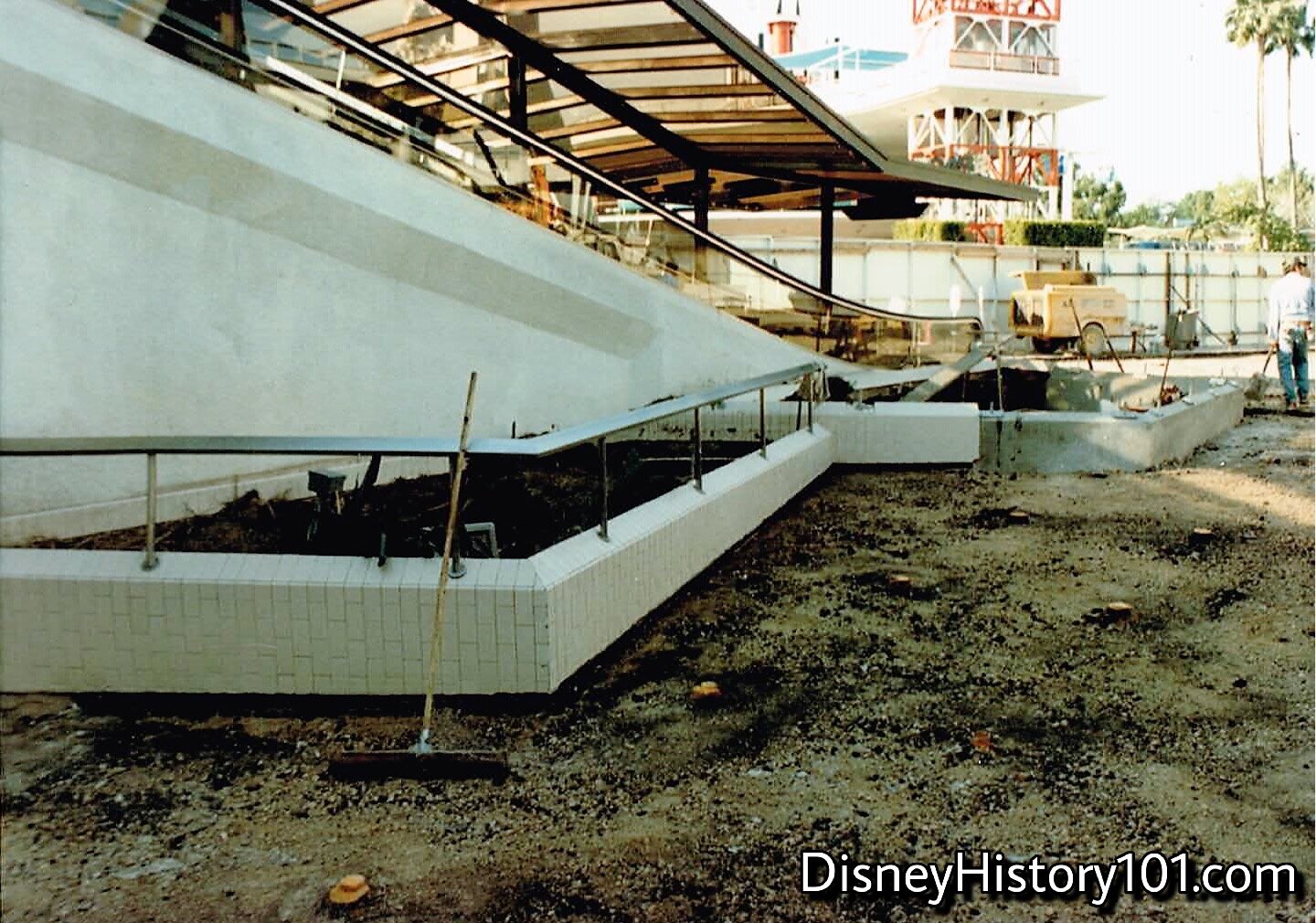
Disneyland “queue lines” were designed as part of the attraction to make the Guests' time in line as comfortable as possible.
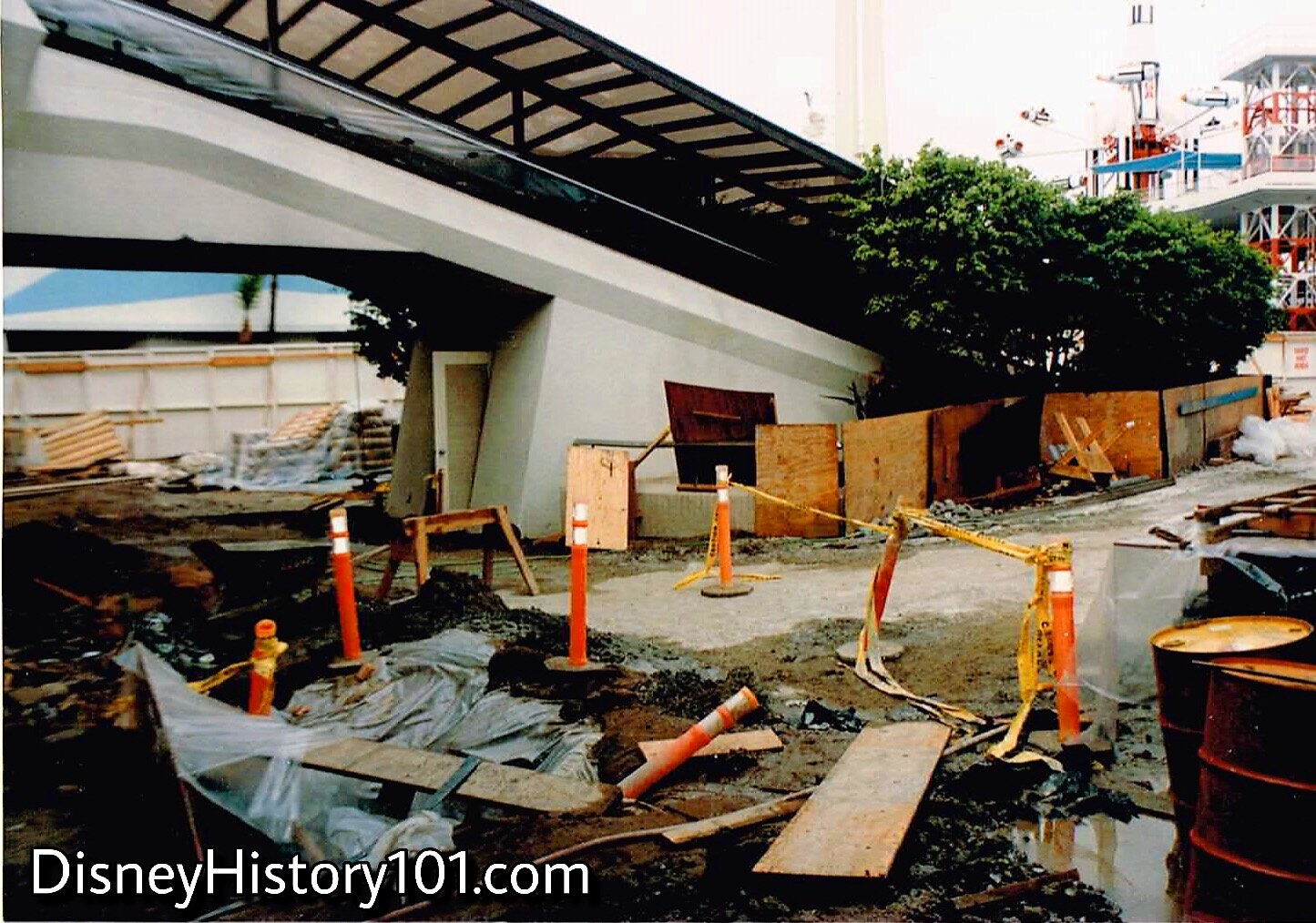
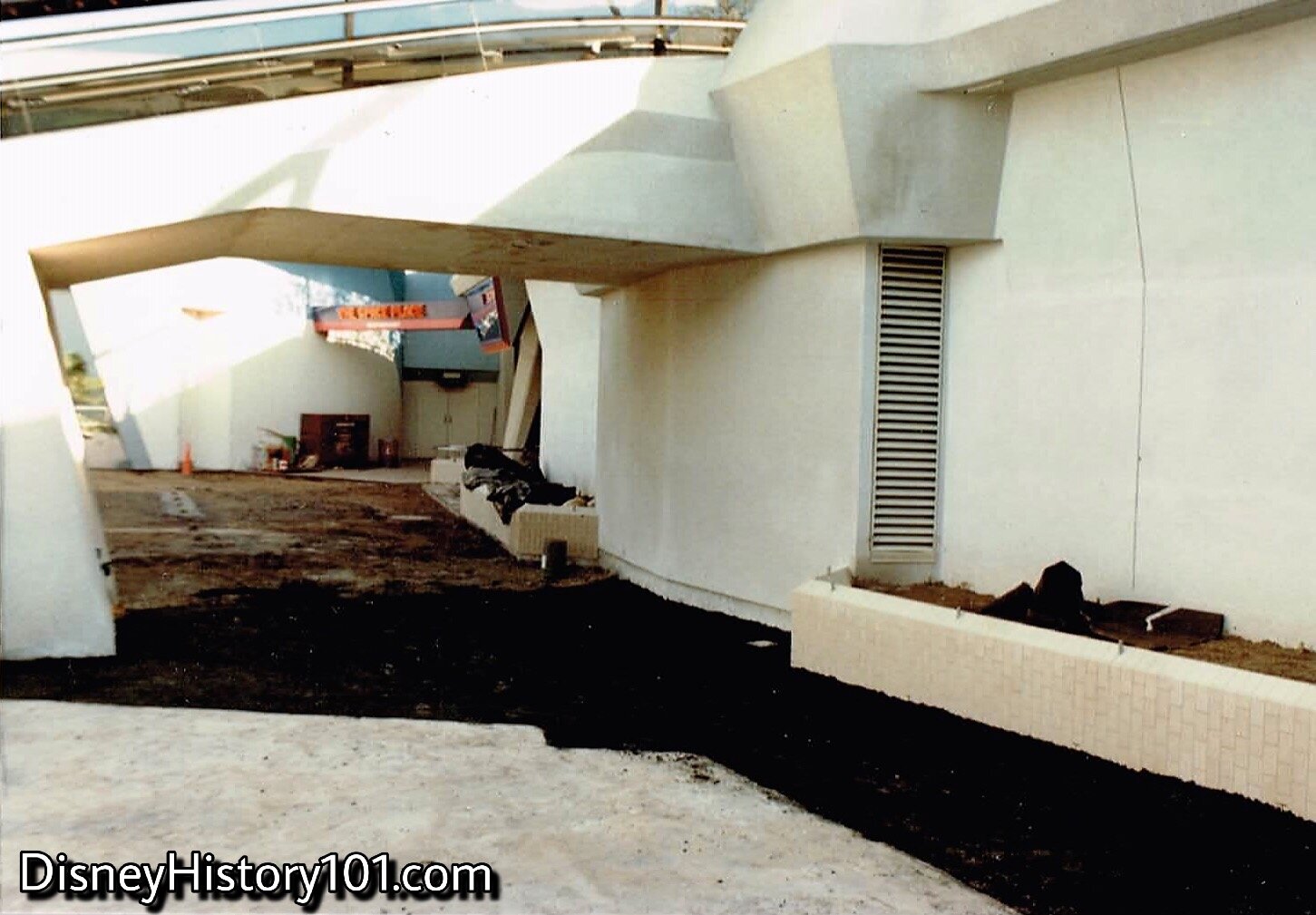
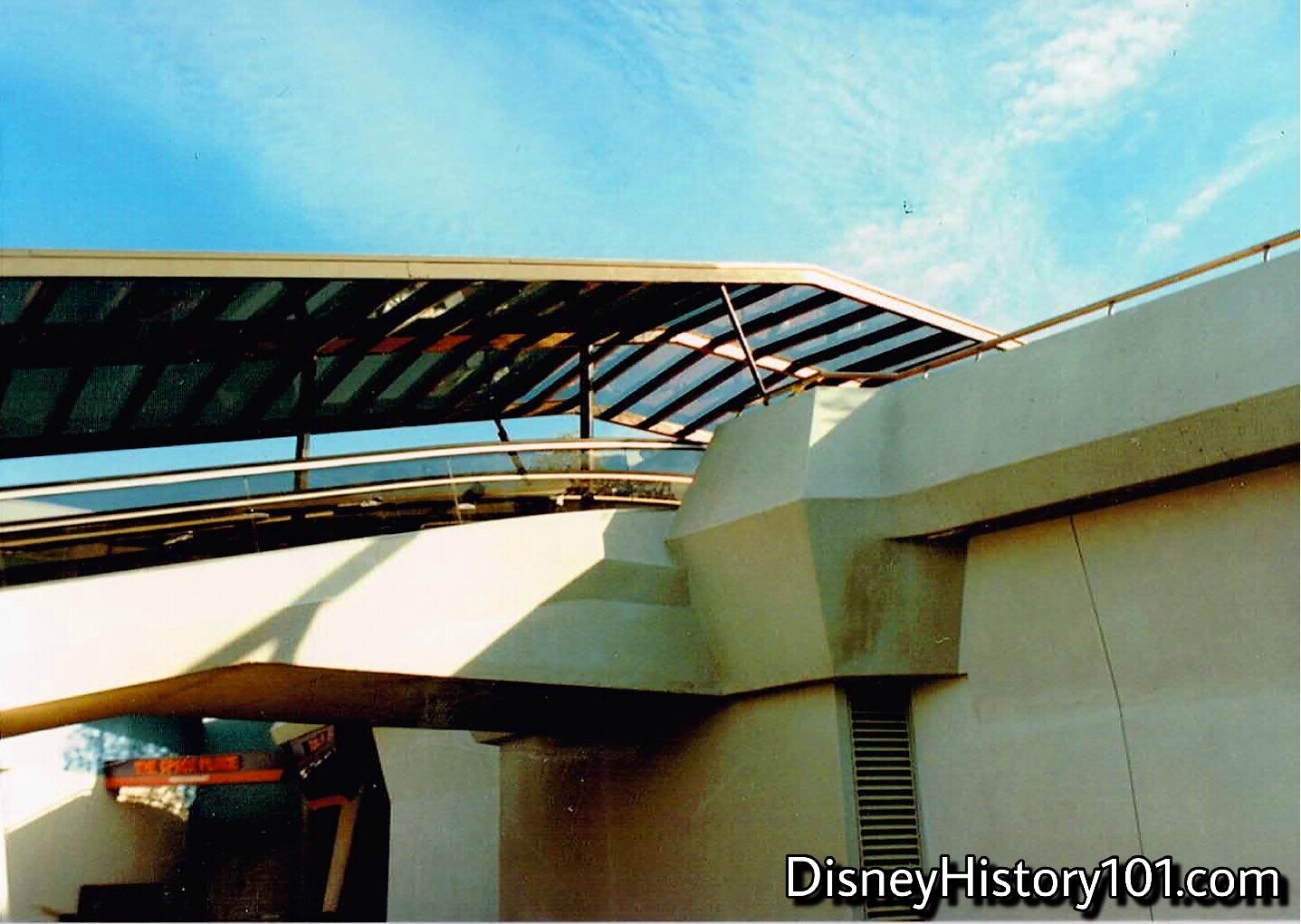
Two moving sidewalks (similar to the Stephens-Adamson Speedramp at the Tomorrowland Monorail Station) were installed in front of Space Mountain. These Speedramps would help guests to the upper concourse (and ride entrance).
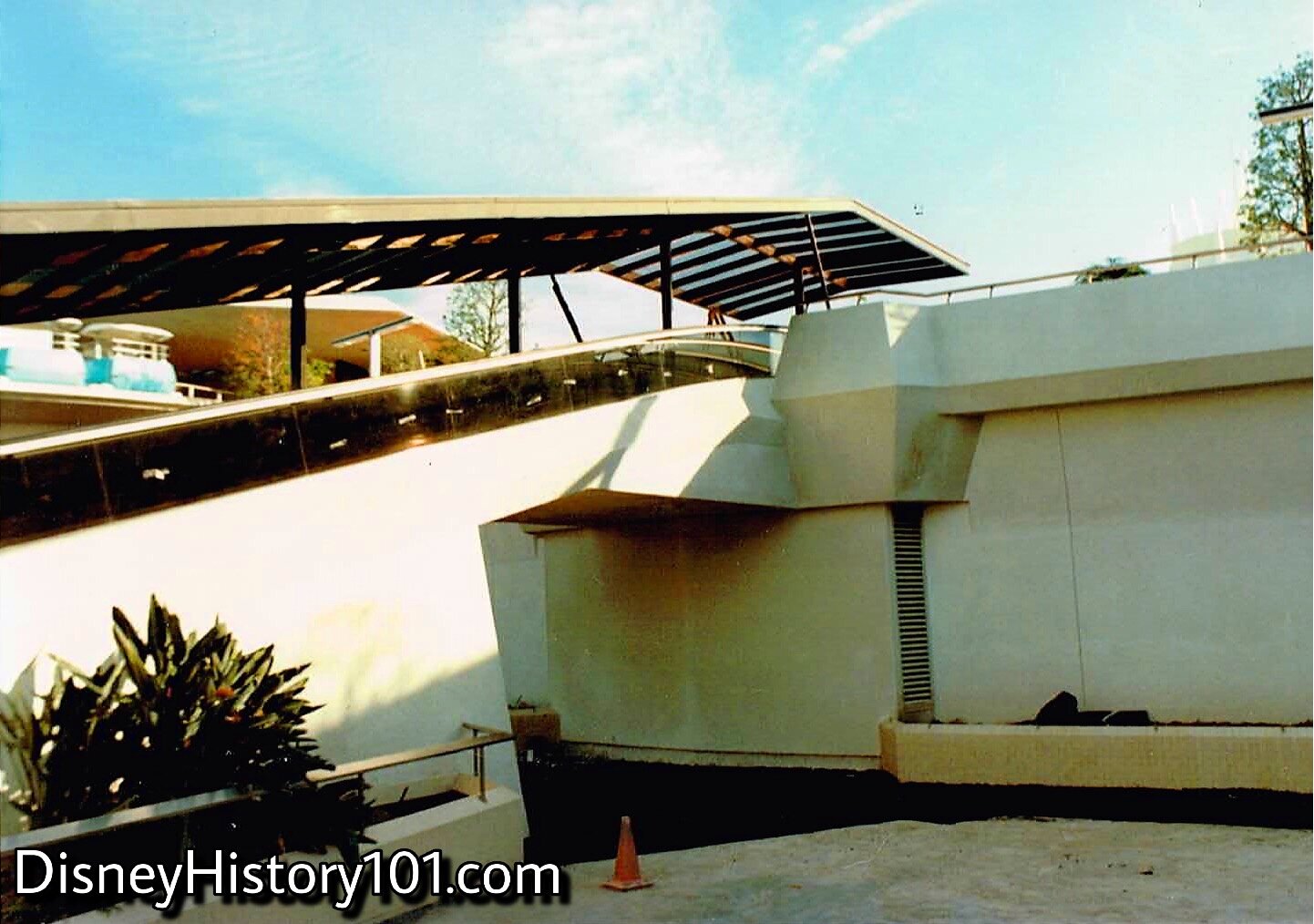
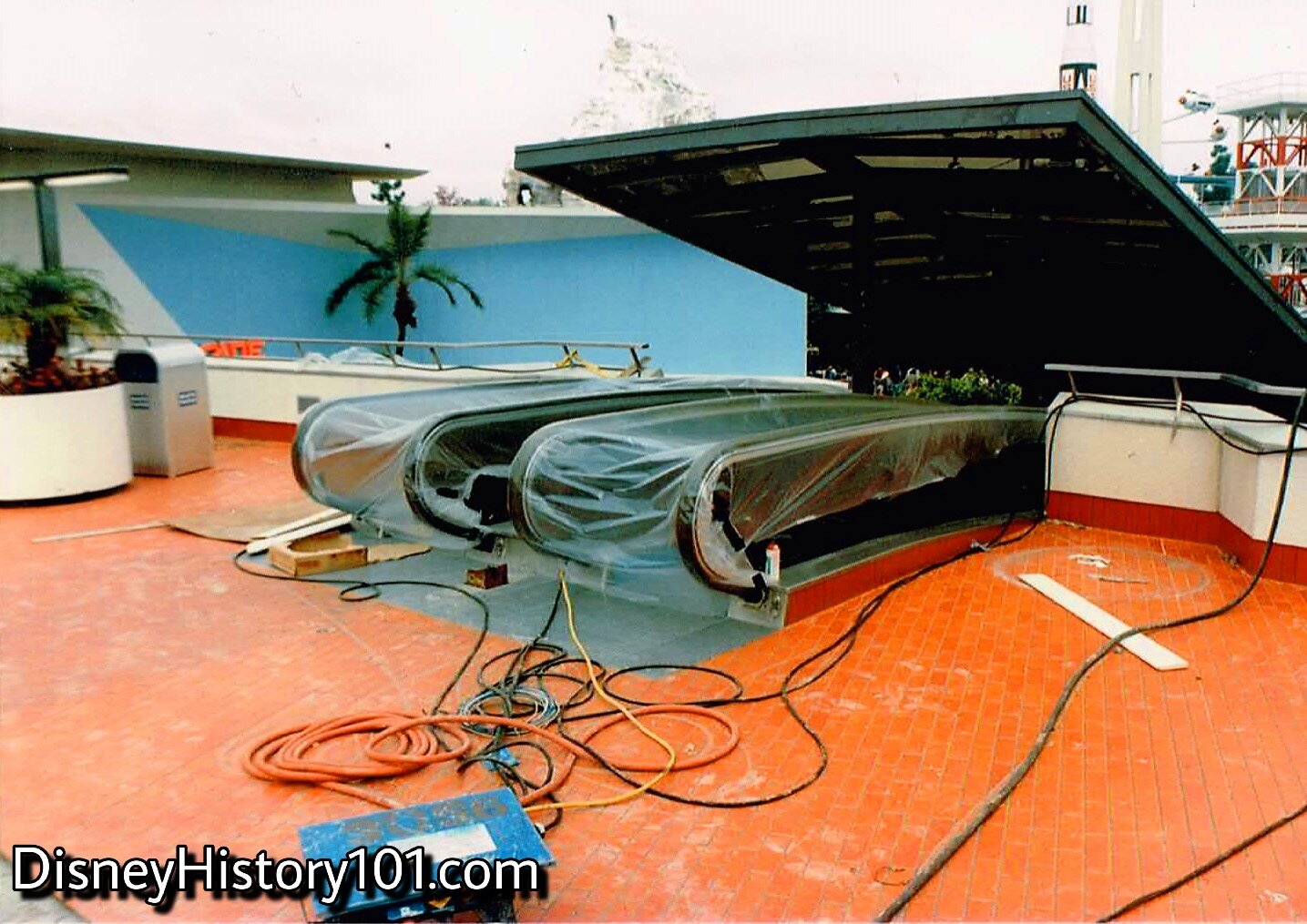
In 1981, the “I-Have-An-Idea” Program yielded new Starcade and Space Mountain Speed Ramp handrails, courtesy of Phil Hilde, Larry Johnson, and Virgil Stroud of the Disneyland Mechanical Department. Under the older system the handrails were wearing out and being replaced every three weeks. Under the new Guest Control queue area routing system, the handrails only needed to be replaced every four or five months.
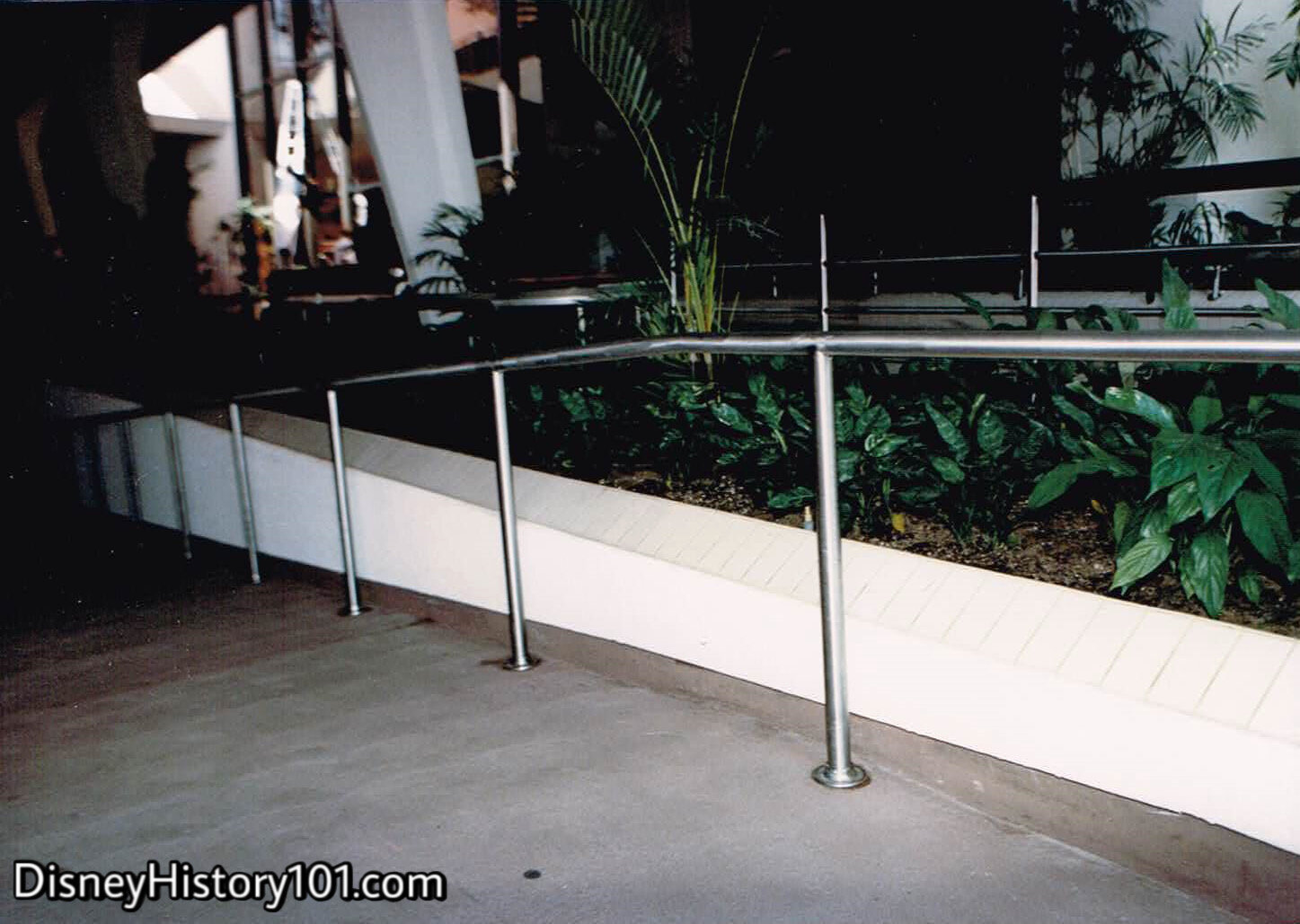
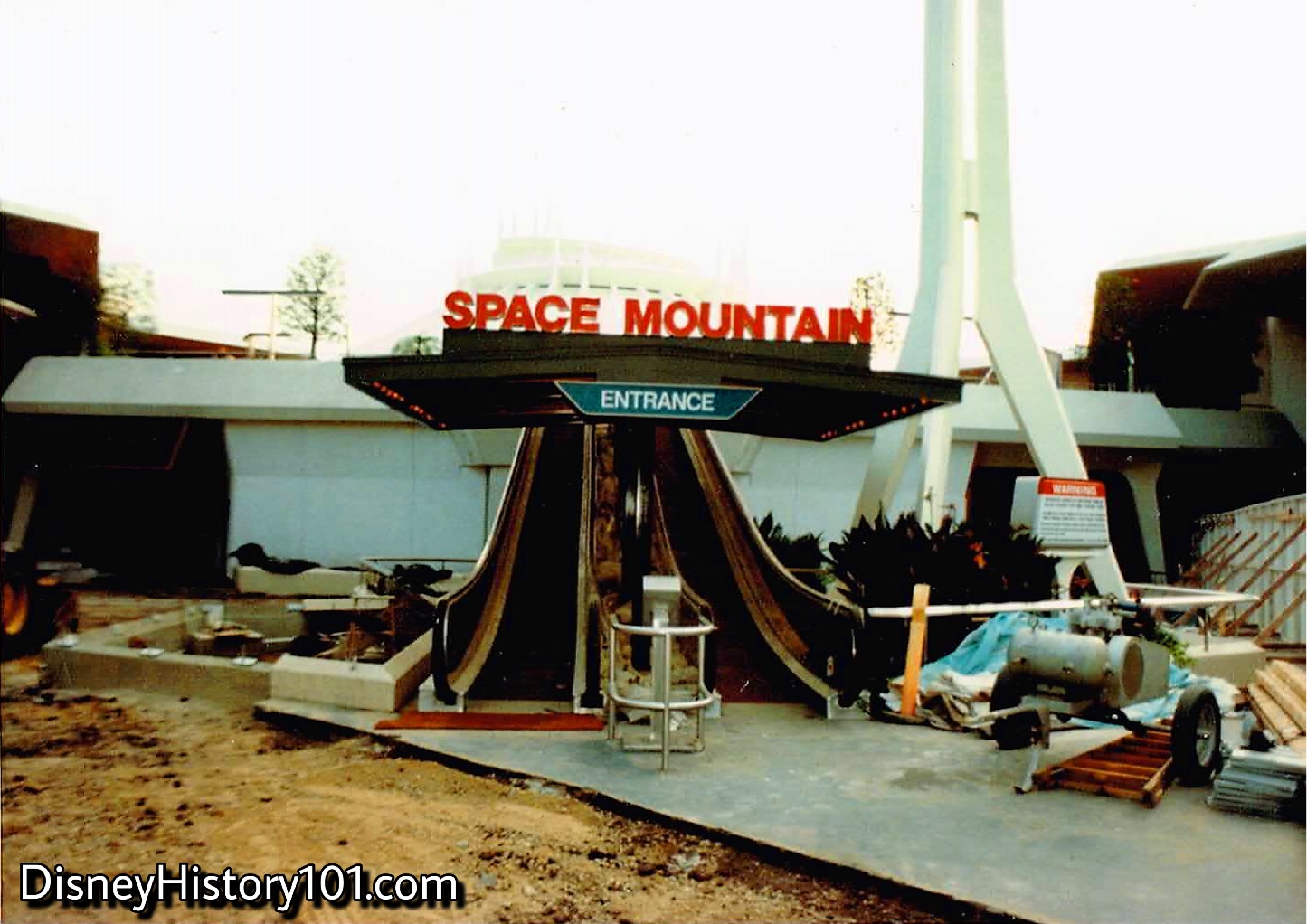
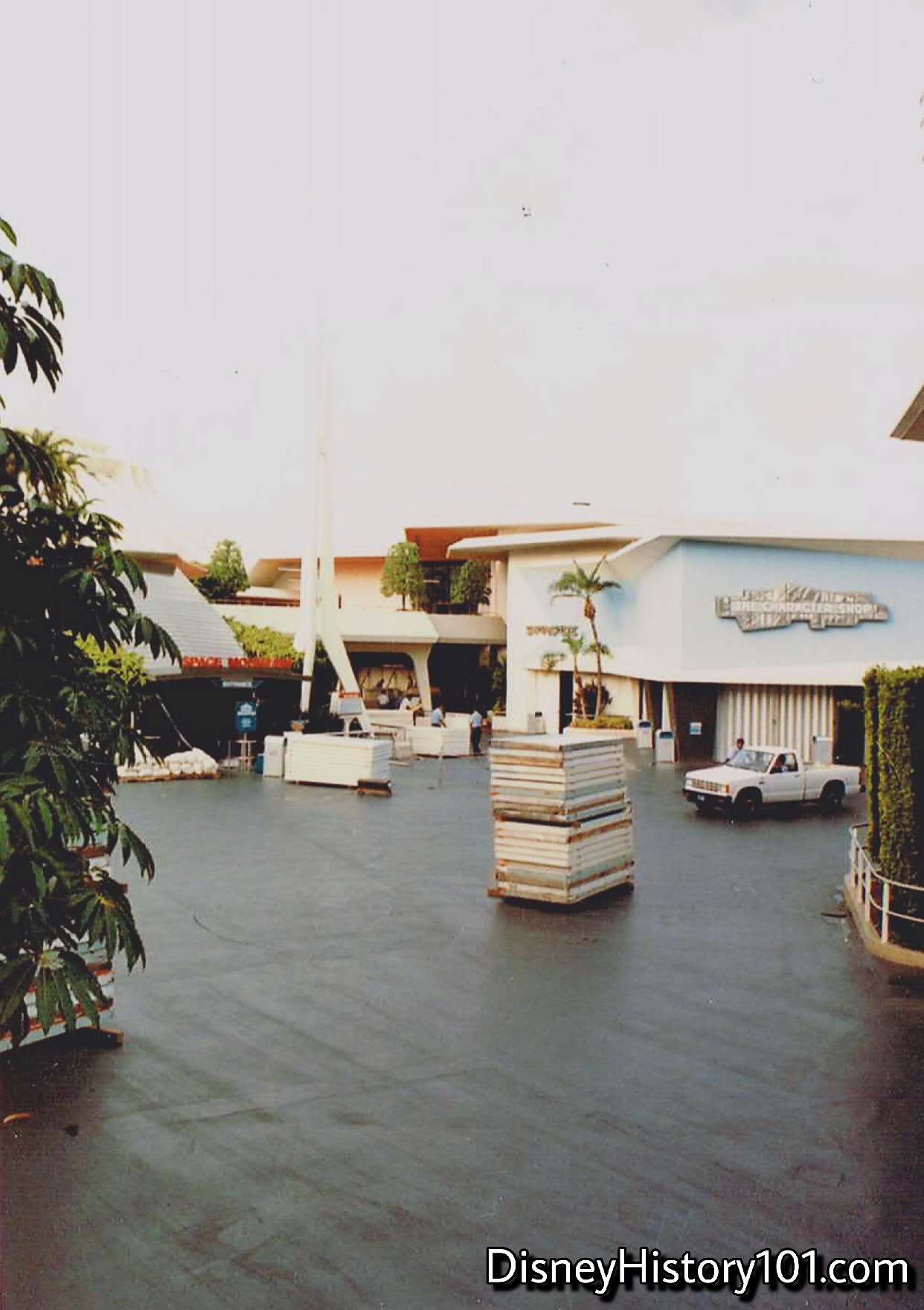
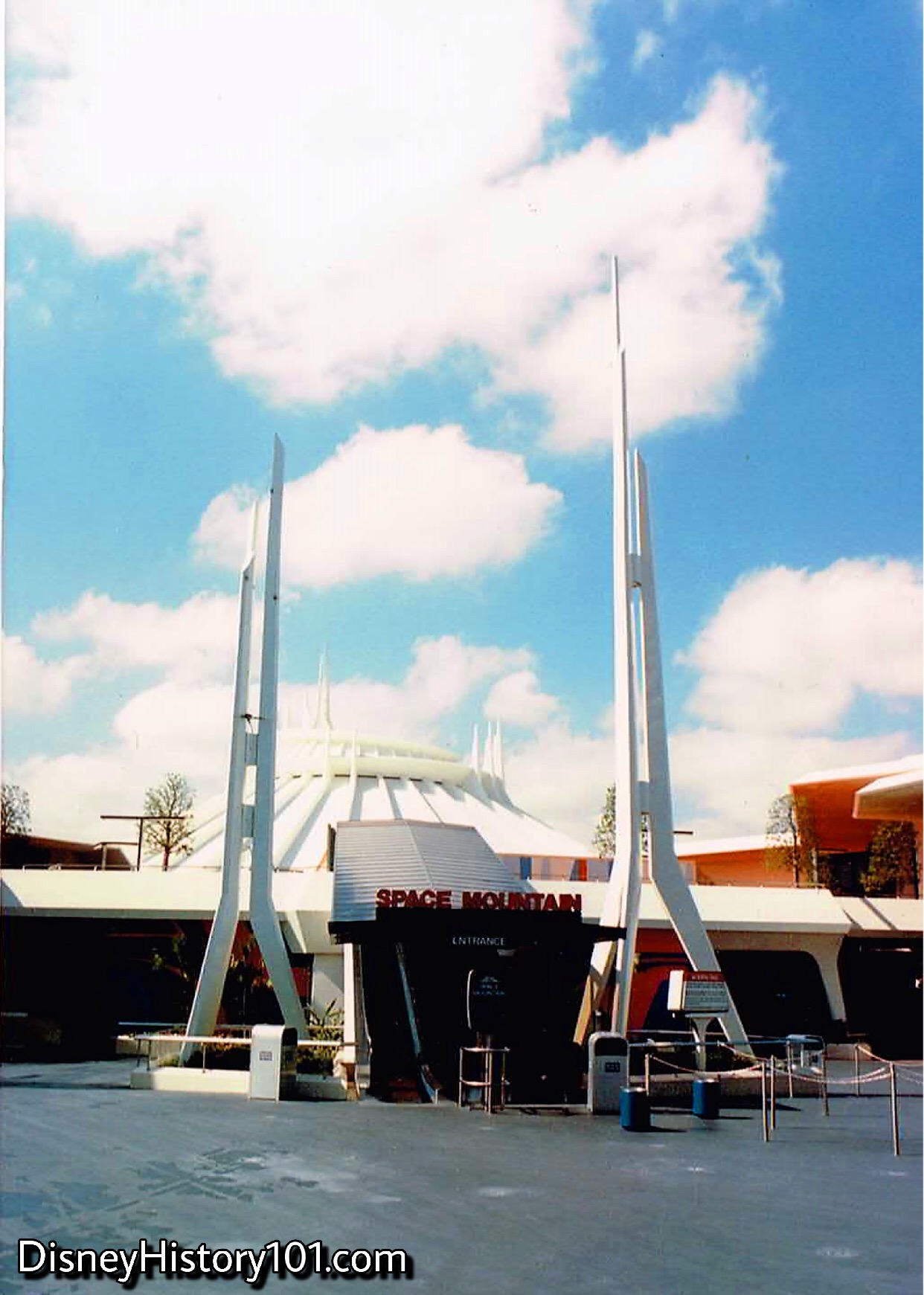
Two coats of an Elastomeric Coating are applied (over a span of weeks) to the 100,000 square feet of peaks that comprise the surface of the Space Mountain complex. The resulting finish will last up to five years according to Disneyland LINE (June 29, 1978).
Due to the ongoing construction in the Backstage Area, the Hills Bros. Gate was not used during the Easter Parade of April 10, 1977 (at 2:00 pm). The route would run from the Fire Station Gate to the Small World East Gate.
After 12 years of planning and two years of construction, Space Mountain was completed during May of 1977. Press Release packets divulged the following “operational data” about Space Mountain.
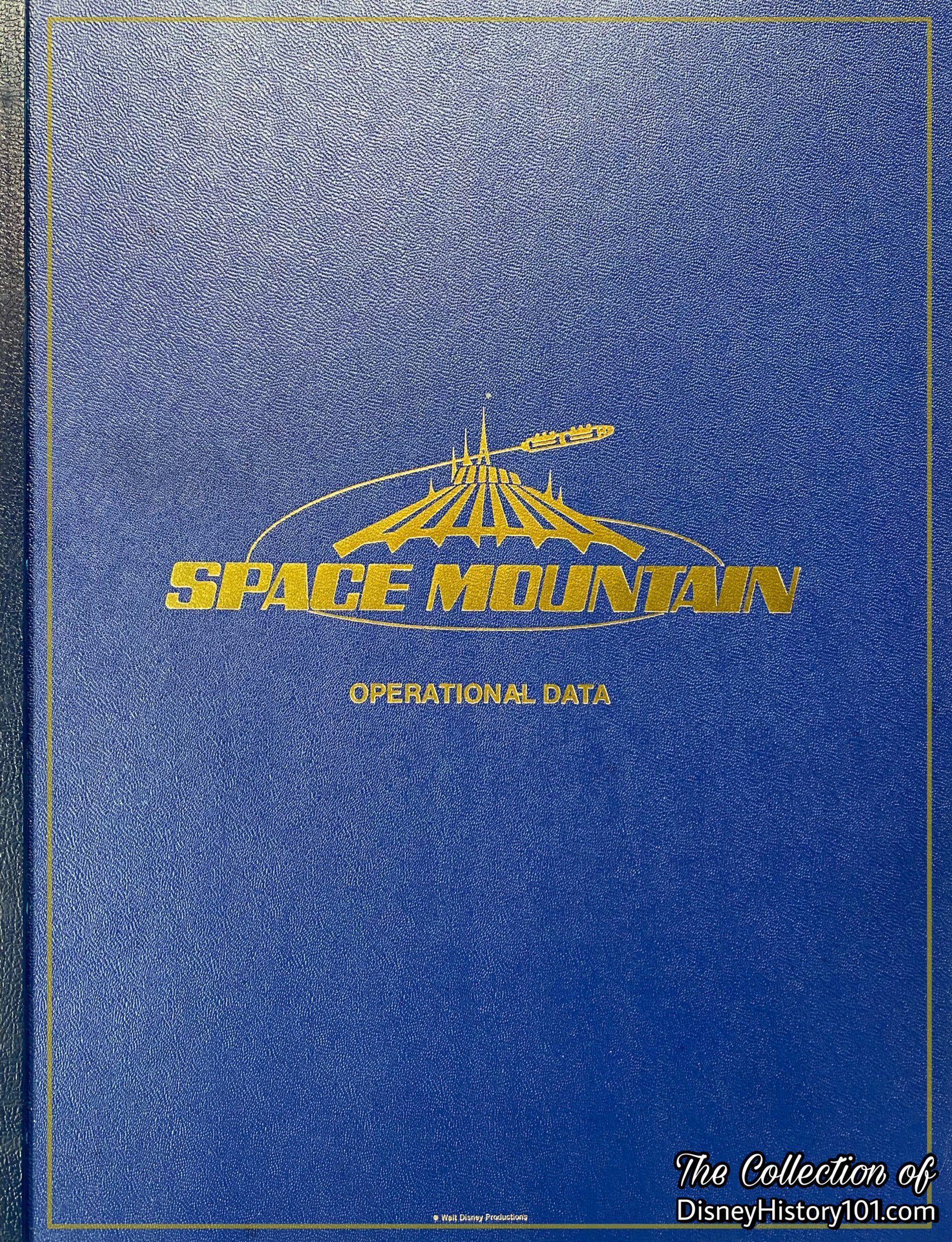
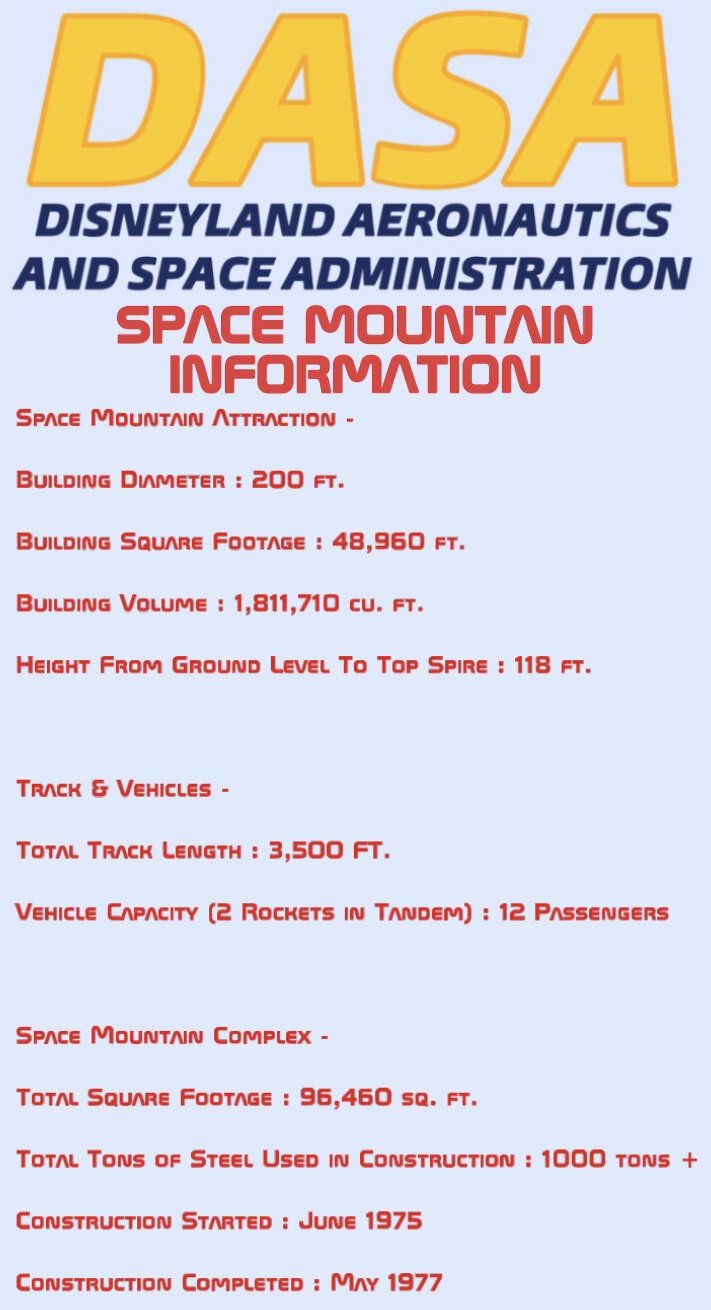
Disneyland Publicity Writers of the Marketing Division (Bob Roth, Frank Whiteley, and Al Flores) were very busy brainstorming Press campaigns related to the big grand opening! Meanwhile, quite a few Disneyland Cast Members recall becoming “test pilots.”
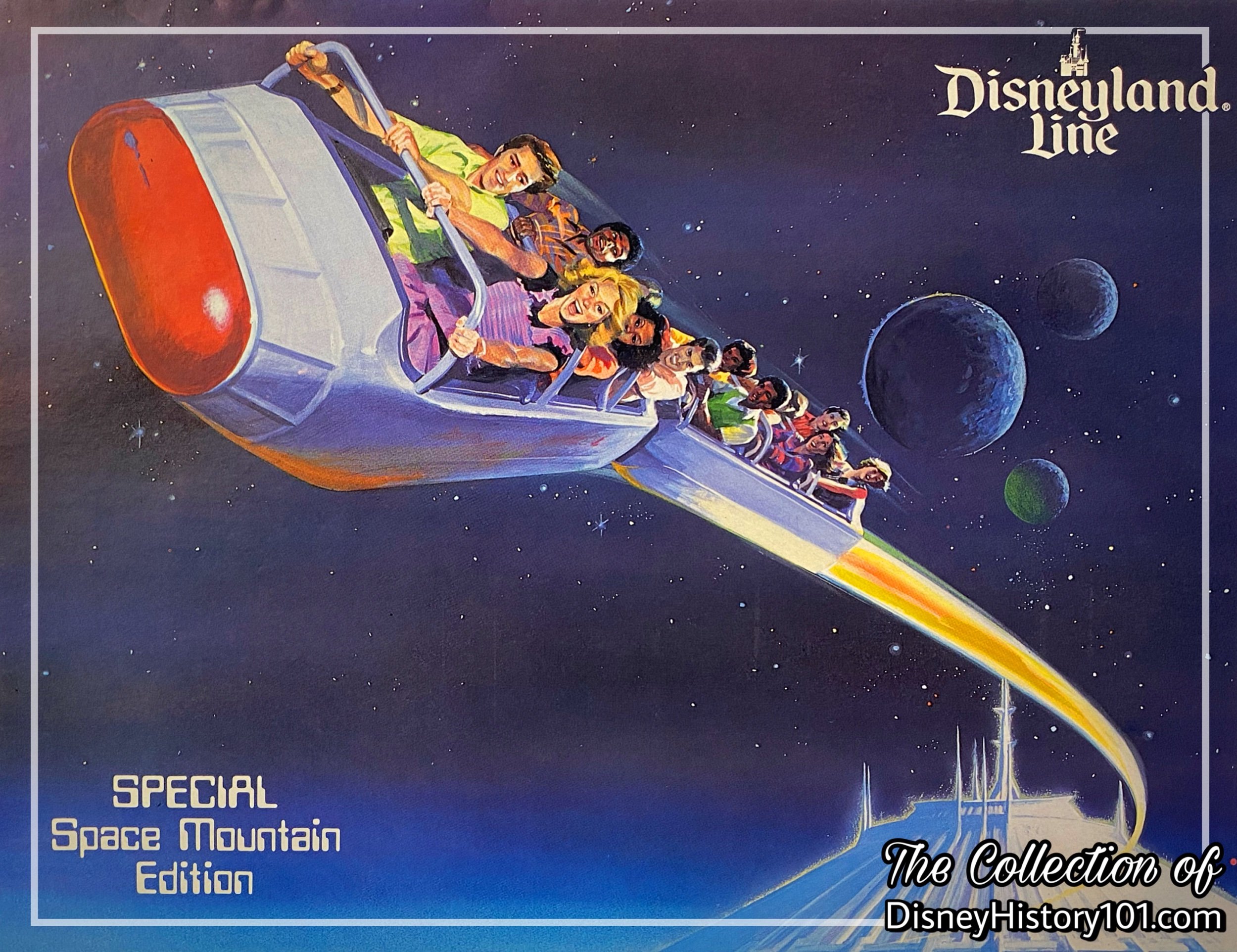
According to writer Donia Ruescher:
“Space Mountain captures the essence of Superspace. The expectant ‘space voyager’ is transported through the space station launch portal, and through the vast man-made ‘solar field.’ He then orbits the glowing ‘satellite,’ become engulfed in spectacular nebulae and plunges past myriads of strange stars and unknown galaxies to begin reentry.”
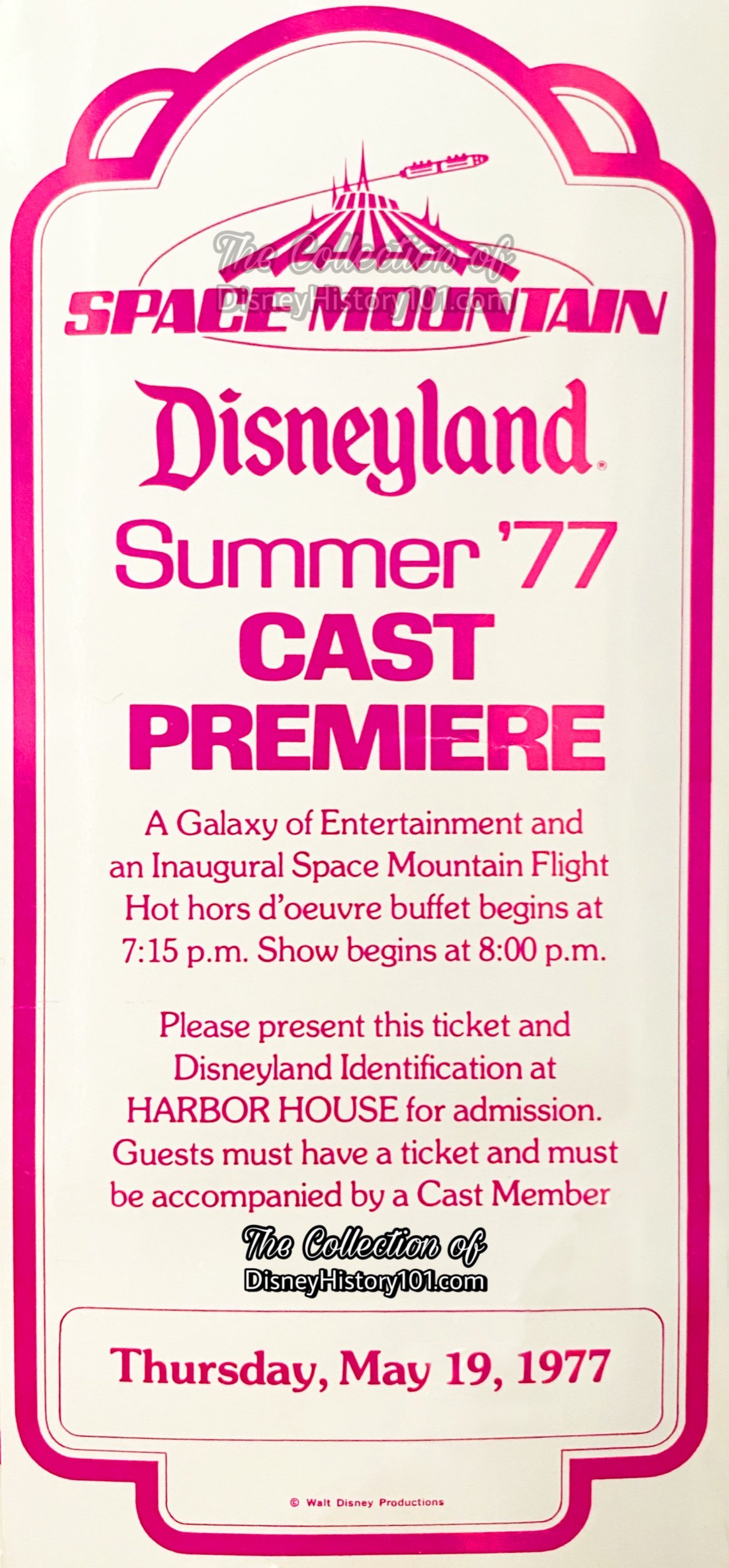
While a few fortunate Disneyland Cast Members recalled test piloting Space Mountain well before the official Disneyland Cast Premier, most of the Cast attended the Disneyland Cast Premier to be accounted among the Inaugural Flight Crew. These lucky astronauts were given these mementos of their journey!
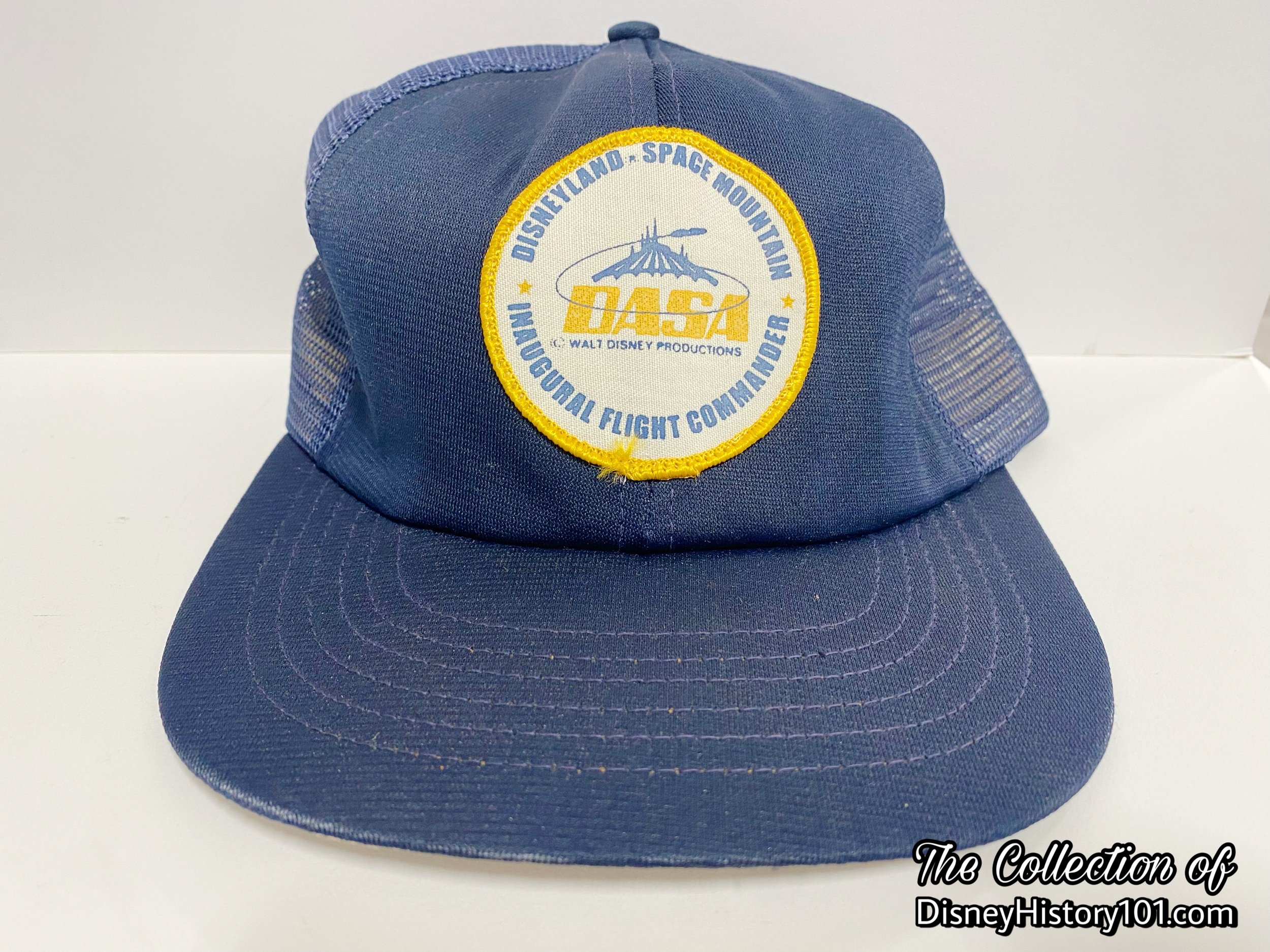
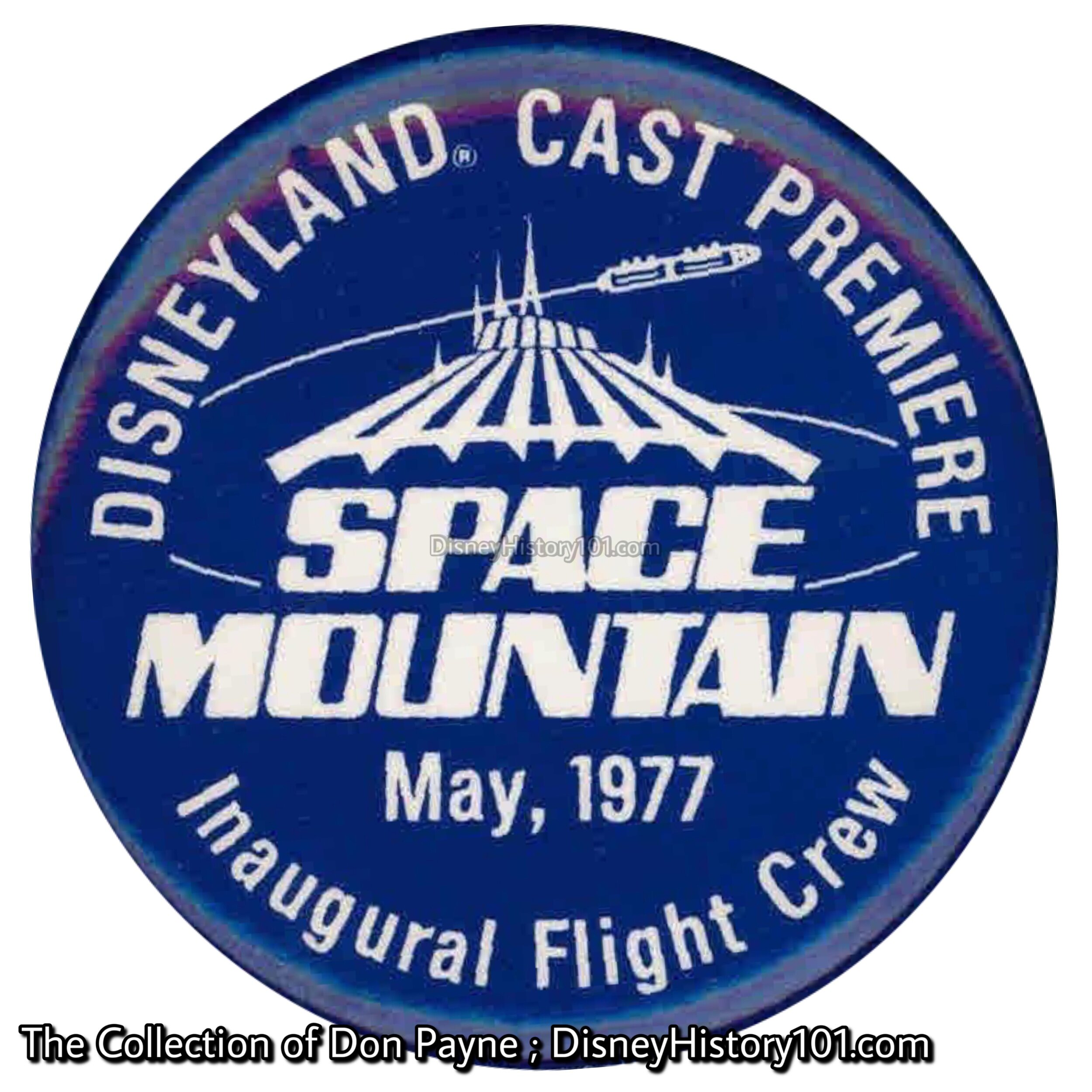
“More than 6,000 Disneyland Cast Members and their guests enjoyed Space Mountain Cast Premiere ceremonies over five nights during the last two weeks in preparation for the Grand Opening of our new Tomorrowland addition this Friday, May 27.” [Disneyland Line, May 26. 1977]
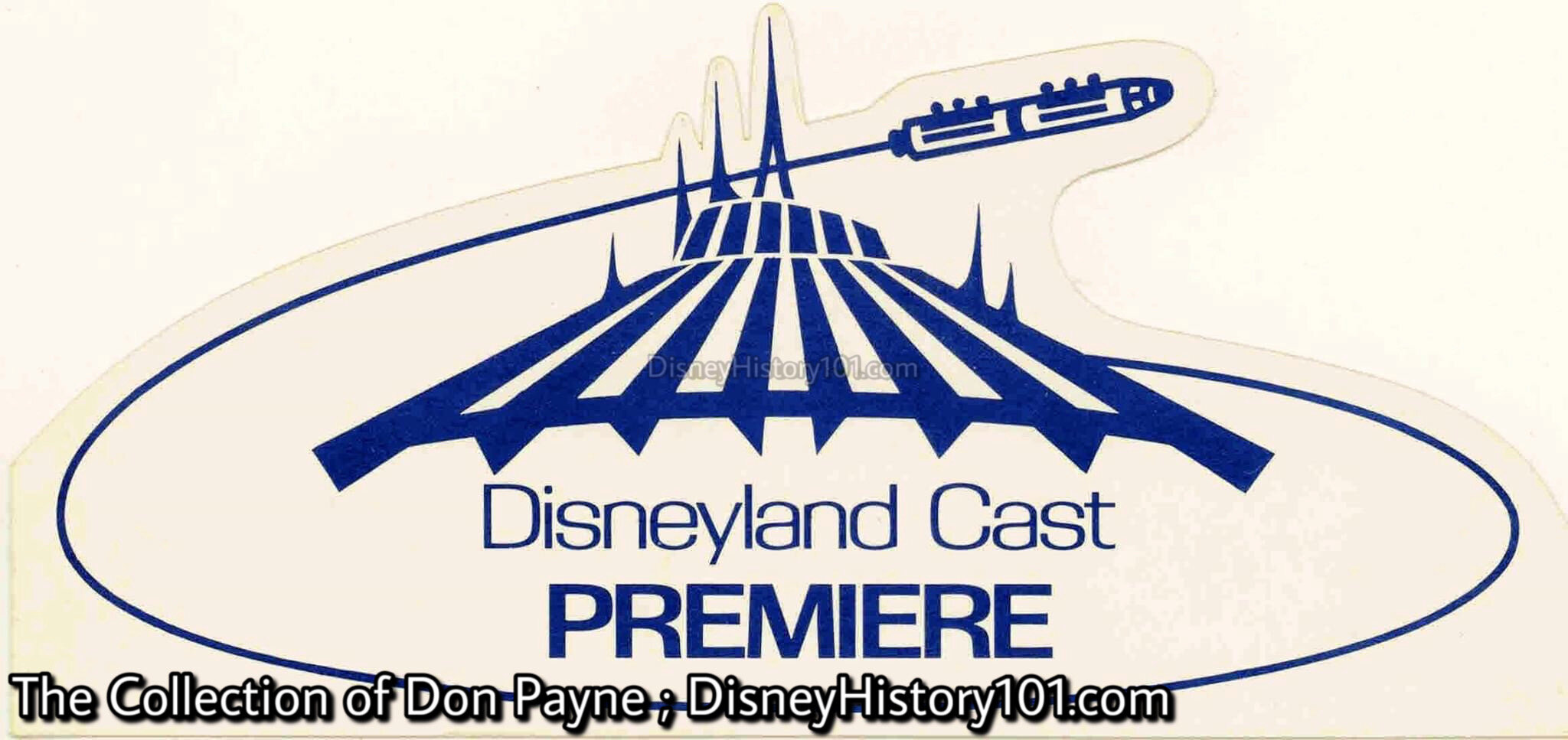
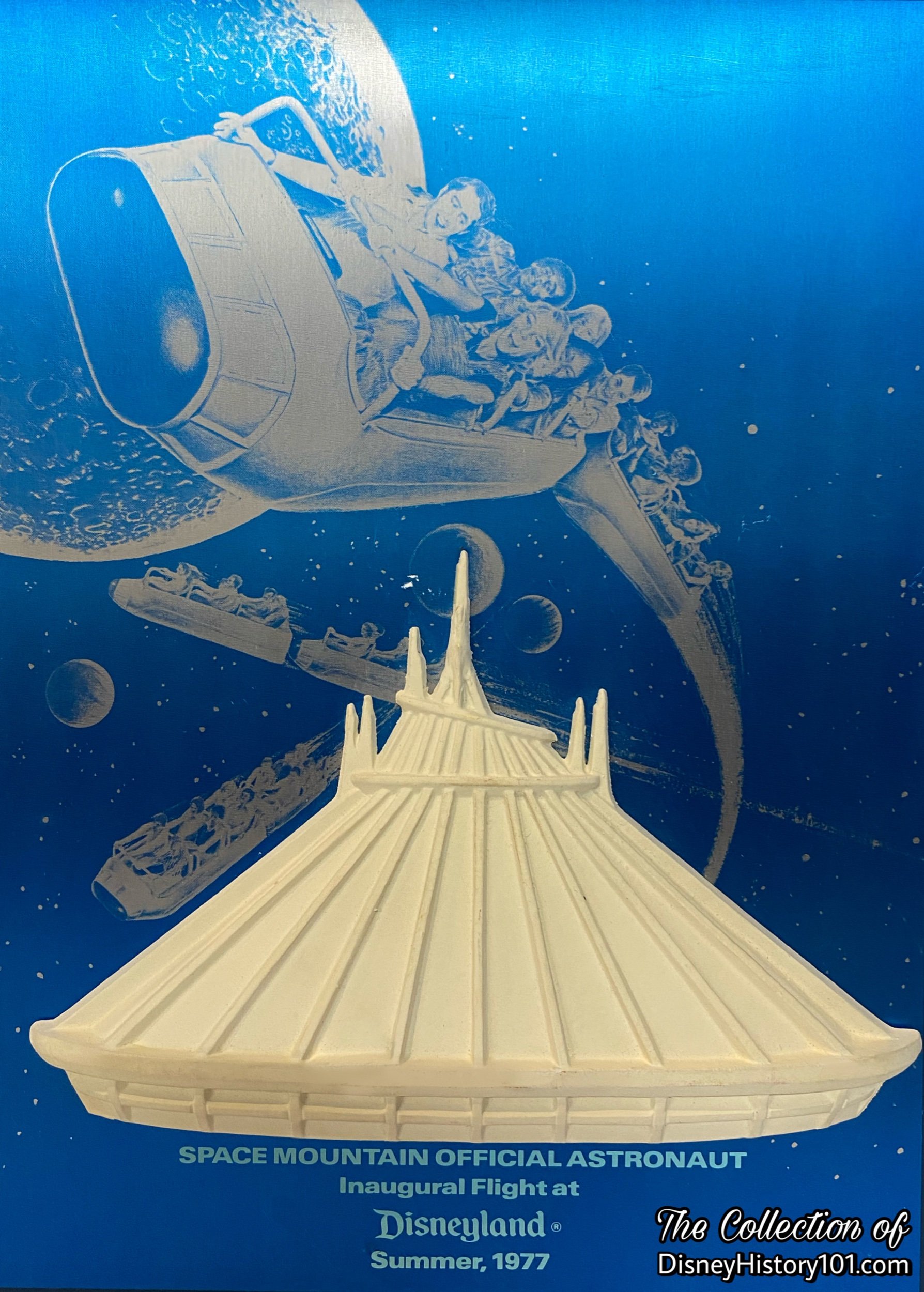

On May 27, 1977, “space travelers” led by true-life Mercury astronauts (Alan Shepard Jr., Walter Schirra Jr., Virgil Grissom, Colonel L. Gordon Cooper, Donald Slayton, Commander M. Scott Carpenter, and William Douglas) were gathered after eighteen years, and welcomed to Futuristic Station - a massive spaceport! Some of these astronauts had been involved with other flights (Mercury 7, Mercury 8, Mercury, 9, Gemini 5, Gemini 6, Apollo 7, Apollo 14, and the Apollo-Soyuz Test Project). Their 18-year reunion was officiated by Disneyland Ambassador Susan Donald, and would span three days (May 27 - 29, 1977). These were joined by John Glenn Jr. (of Mercury 6) for a tour on the Saturday following the Grand Opening. For now (May 27th, 1977), these astronauts entered the attraction queue, and stepped aboard futuristic Speedramps (in service from 1977 to 1997), to help move comfortably from the ground floor to the upper level of Tomorrowland. Transmissions from Mission Control and Flight Dispatch echo through the Space Port, as the Mission Status Board charts current Space Flights. Guests make their way past windows where rockets streak by with flashes of light (as stars glitter in the distance). After passing below the hovering Intergalactic Probe (which “warms its engines for an explorative venture into the unknown”), guests boarded one (of twelve) sleek rockets bound for the “vast dark void of outer space”. Moving slowly along an ascent, the rockets prepare for “blast-off”. Their ascent takes them through meteor showers, “passing through the apparent infinity of a Solar Energizer, where chasms of light seem to stretch forever”. Circling a glowing geodesic satellite, the rockets approach a colorful gaseous nebula, shooting stars falling to each side. Suddenly the rockets reach the apogee of their ascent and quickly plunge into the realm of ‘Superspace’, where time is non-existent and distances are spanned at infinite speeds. Roaring past unexplored galaxies the rockets twist, turn and dip thier way home, finally bursting through a cosmic vapor curtain before slowing to landing speed at the Space Port”, according to the Disneyland Aeronautics and Space Administration’s “Space Mountain Rockets.”
Even after that event, a WED/MAPO Official Inaugural Flight event was held on June 2nd, 1977, with commemorative posters given to all those who participated.

Disneyland’s spectacular new $20 million voyage thru outer space (or, journey along 3,450 feet of track, at maximum speeds of 30 to 32 miles per hour) - Space Mountain - was “the most incredible attraction in 22 years,” according to Vacationland magazine, Summer, 1977). Eight years after the live broadcast of the Apollo Moon Landing was viewed (on this very location) and during the summer of 1977, thousands of Disneyland Guests waited in lines to board Space Mountain. These impressive lines (“kept on queue” by Audience Control Crews) wound all the way through the Tomorrowland Mall, and clear to the entrance of Tomorrowland (a picture of this can be viewed in “Backstage,” Summer of 1977). Just two years later (by 1979 - 1980), it was still just as “incredible,” as admission for a flight through Space Mountain was one “E” coupon, the same as passage down the icy slopes of the Matterhorn, stepping aboard Big Thunder Mountain Railroad, or admission to the Country Bear Jamboree. This was with good reason - Space Mountain was a realization of one of Walt’s “dreams”! At this point, we must recall the words of John Hench who once said, “We didn’t just build this because we needed another thrill attraction…Walt always intended this to be here and we never abandoned the idea.”
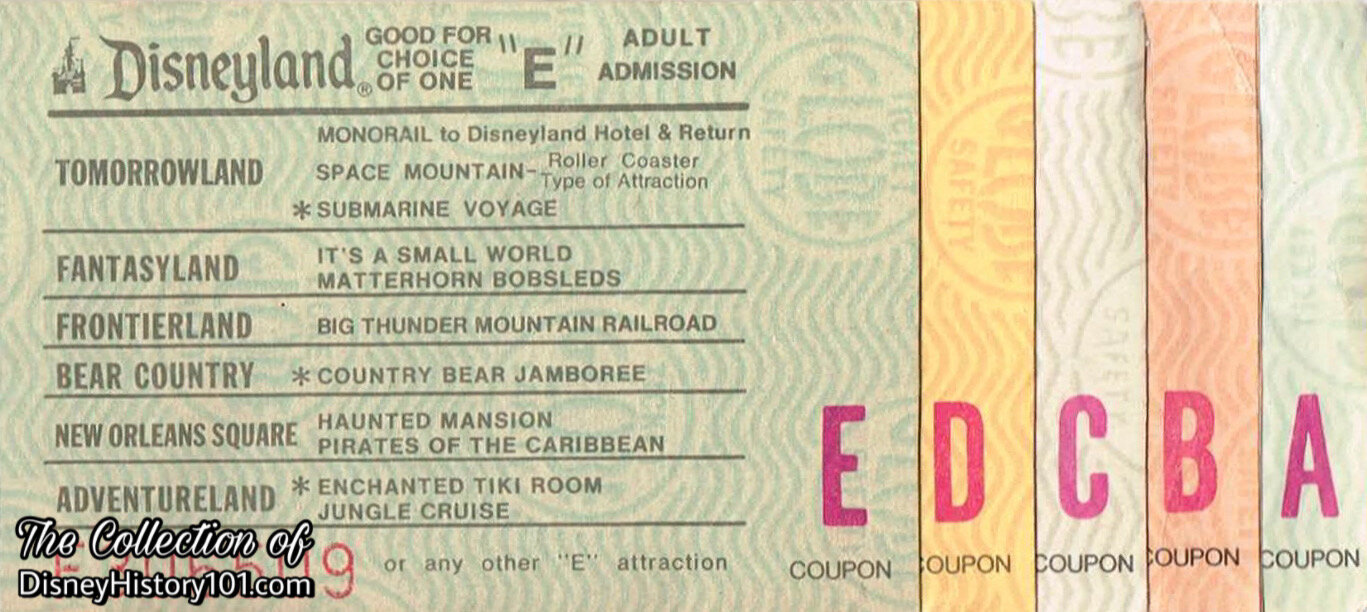
The Disneyland Planning Department prevented having too many attractions of the same ticket value down at the same time.
While five years of negotiations were underway for Tokyo Disneyland, it was decided to bring the smaller incarnation of Space Mountain (Disneyland, Anaheim, California) to Japanese guests! Space Mountain opened at Tokyo Disneyland, on April 15, 1983!
A new Space Mountain ride control system was installed in 1988, which simplified the role that Hosts and Hostesses performed.
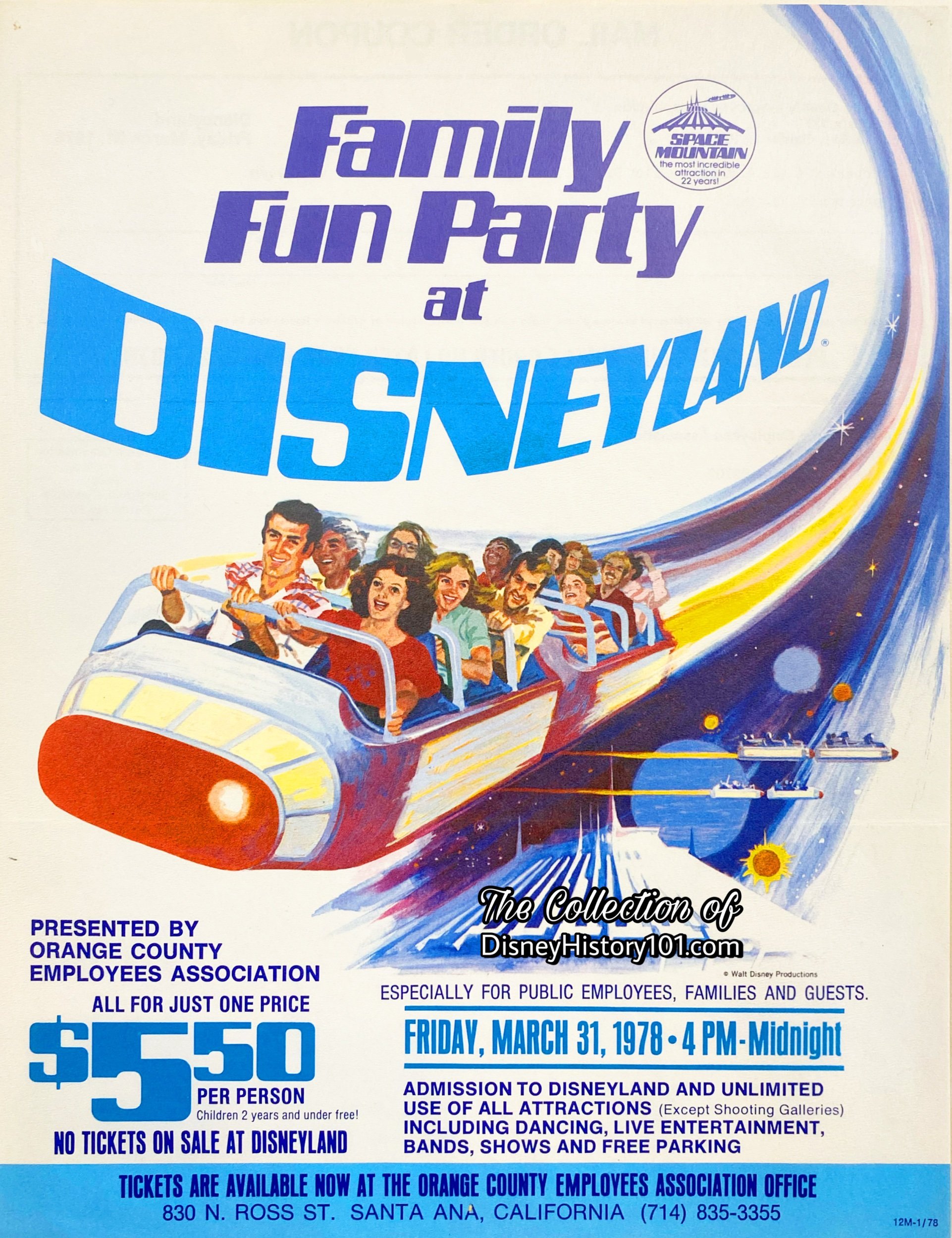
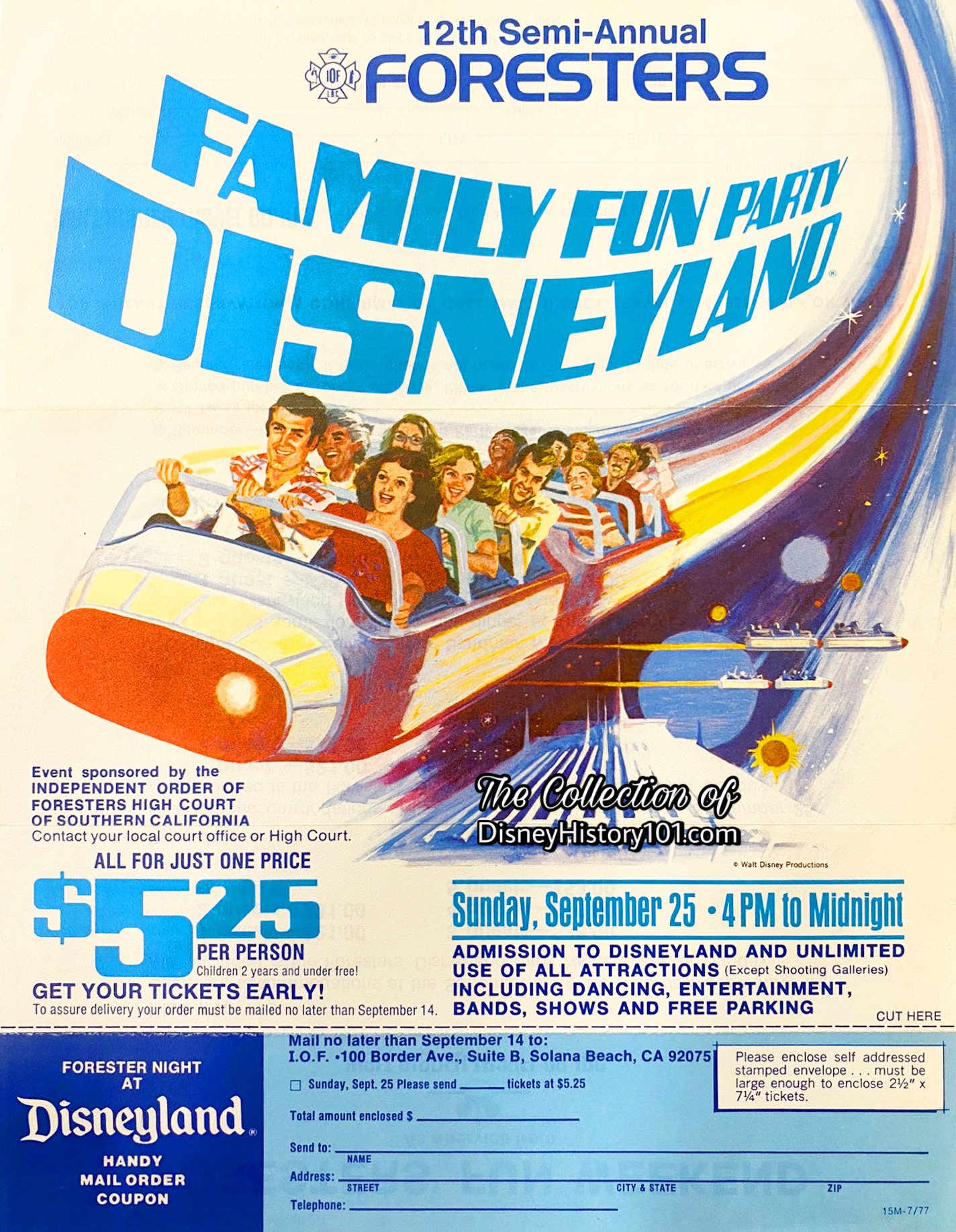
Space Mountain still offered to opportunity to race through outer space to the far reaches of the universe.

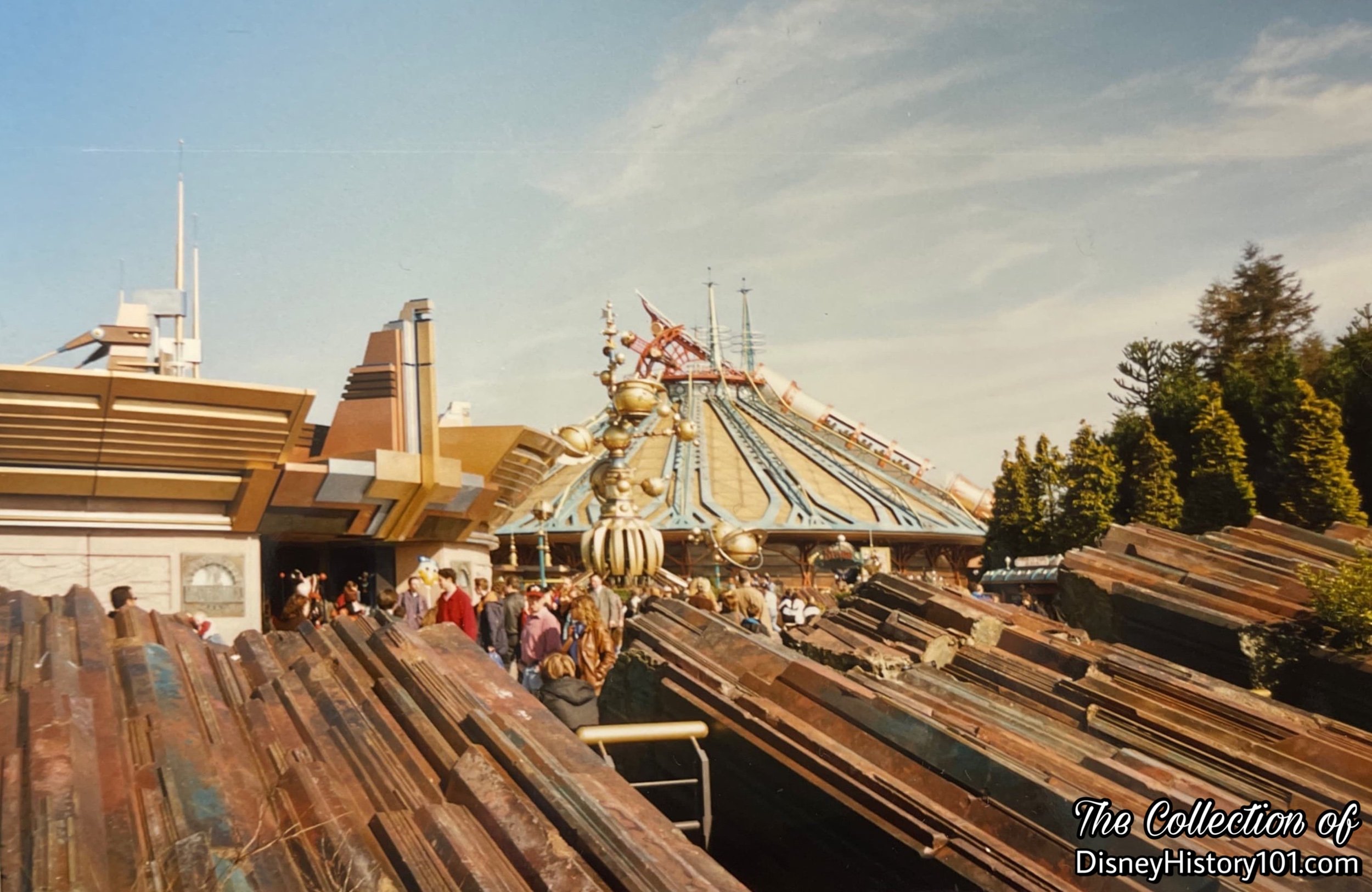
After Euro Disney’s Jules Verne-inspired version of Space Mountain opened (with its higher speed, first-ever loops in a Disney Park, and the first ever synced audio track to a roller coaster-type thrill ride), one of these elements would soon come to Disneyland (in Anaheim, California).

For now, this (prior Vintage View) was the sight of Space Mountain.
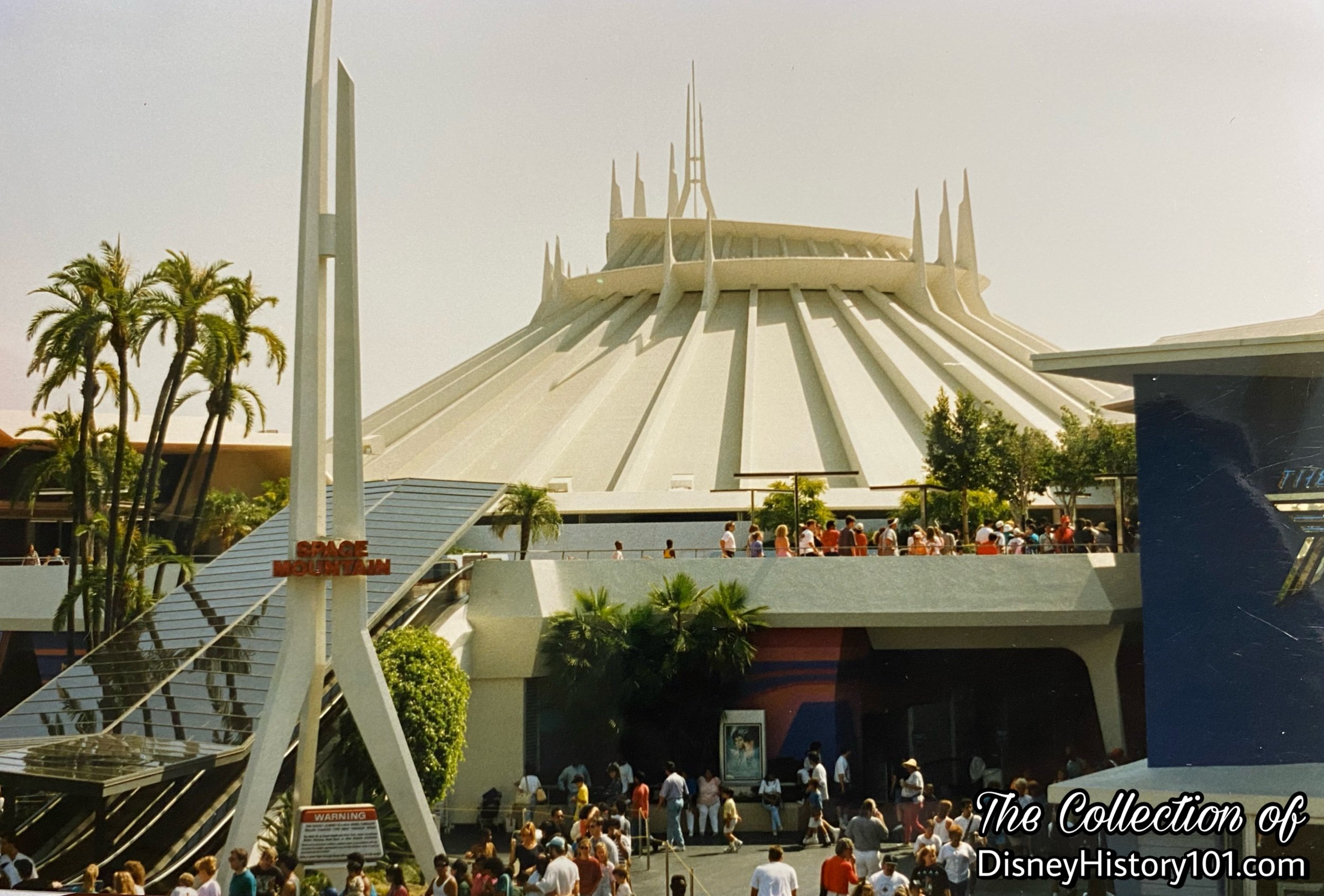

“Safety”
Safety is a major concern of the Park Operations Crew. Each day, the M-43 Machinist would make a standard opening inspection of all speed ramps in the area. M-43 would then notify M-41 of any further work to be done or parts needed prior to opening. The M-43 would go to the Space Mountain workshop, read Mechanical log book, and notify M-41 of any further work to be done or parts needed prior to opening.
During each day M-43 would, at least once, circulate to all attractions in T/L and discuss with each attraction lead any problems, defects, or any other feedback regarding the attraction. M-43 would then notify the Mechanical Dept. of anything regarding this department, and notify the M-1 of anything regarding other crafts.
Safety is also a major concern of Engineering. Every year they would make a complete test and inspection of all structural parts of Disneyland. And since Guests would look to Disneyland for their safety the department team was continuously designing new guest and personnel safety devices.
Guests also play a role in safety. This aforementioned sign served as a form of Guest Control, courteously reminding Guests (the elderly, expectant mothers, and those with under age children) to be consider any physical limitations which might be aggravated by the nature of the ride. Guests with any type of back or neck brace and children under three were not permitted to ride. Though signs were posted, the courteous Cast Member also took the responsibility to monitor for under age children and expectant mothers, directing wheelchair guests to the front of the attraction, and determining if a physical limitation might be aggravated by the nature of the ride.
Height restrictions on signs safeguarded guests long before Ride Switch, the process that allowed Guests with children who do not meet age and/or height requirements to enjoy an attraction.
“Federal Express & Pan Galactic News Network Pre Show“
In 1995, Federal Express (FedEx) became a Disneyland Participant as sponsor of Space Mountain. New “magical opportunities” were Imagineered, including improved lighting and effects. A new show entertained the guests leaving the attraction before exiting into the new Tomorrowland Light & Power Co. arcade.
But the biggest change was a brand new 15-minute out-of-this world show created by Eddie Sotto, produced by Doug Miller and Tom Fitzgerald (WED Senior Vice President of Theme Park Productions), and co-written by Seven Spiegel, that featured parody broadcasts and commercials. You may recall humorous clips from PNN (the Pan Galactic News Network), “My Favorite Earthling” (on the UFO Network), and the “Blast Off Channel” (“24 hours of lift-offs, launches and laughs), as viewed through “channel surfed” screens. [See WED Eye Openers, August 15, 1995] Of course, some of the most memorable spoofs parodied concurrent commercials of Space Mountain sponsor Federal Express.
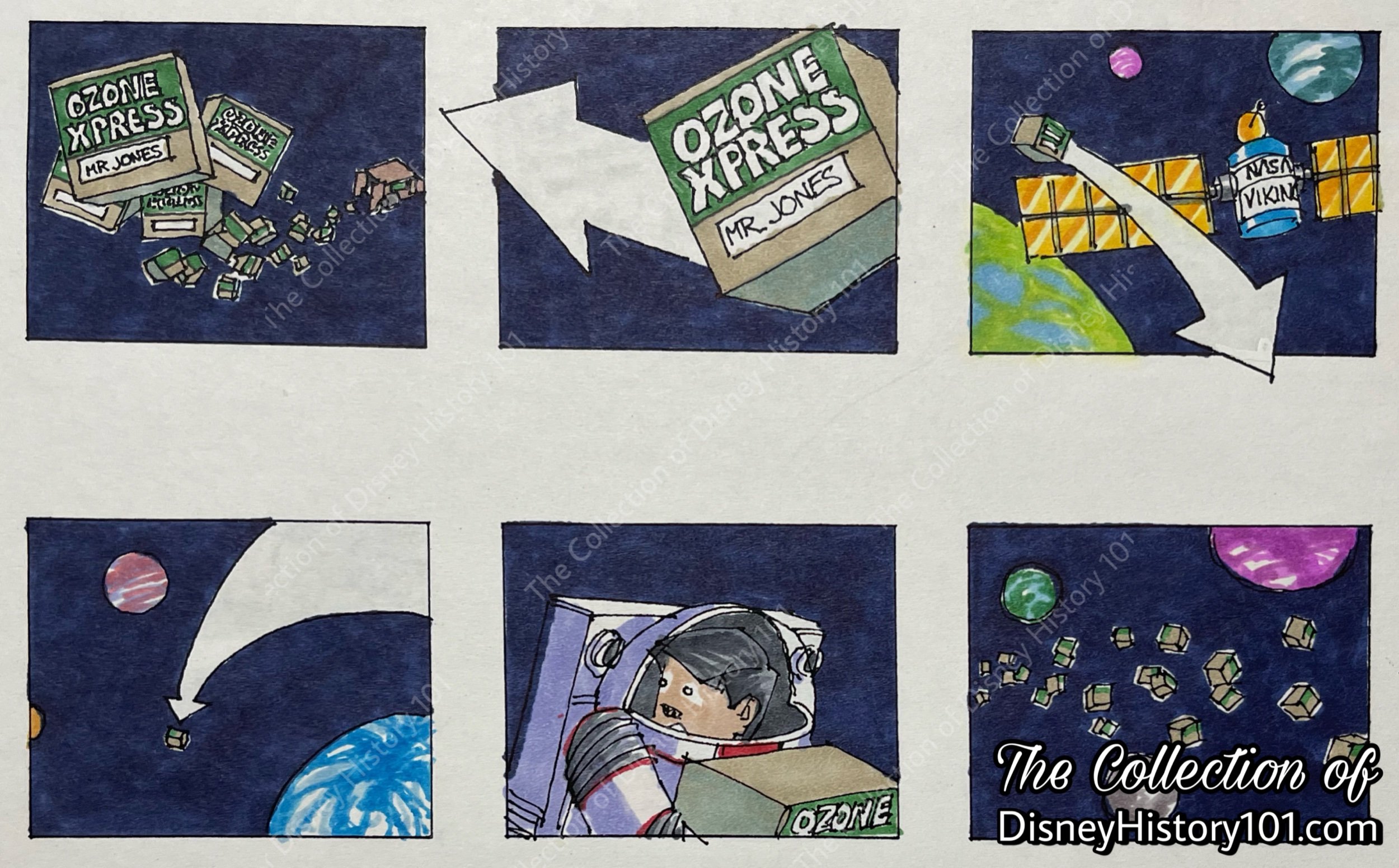
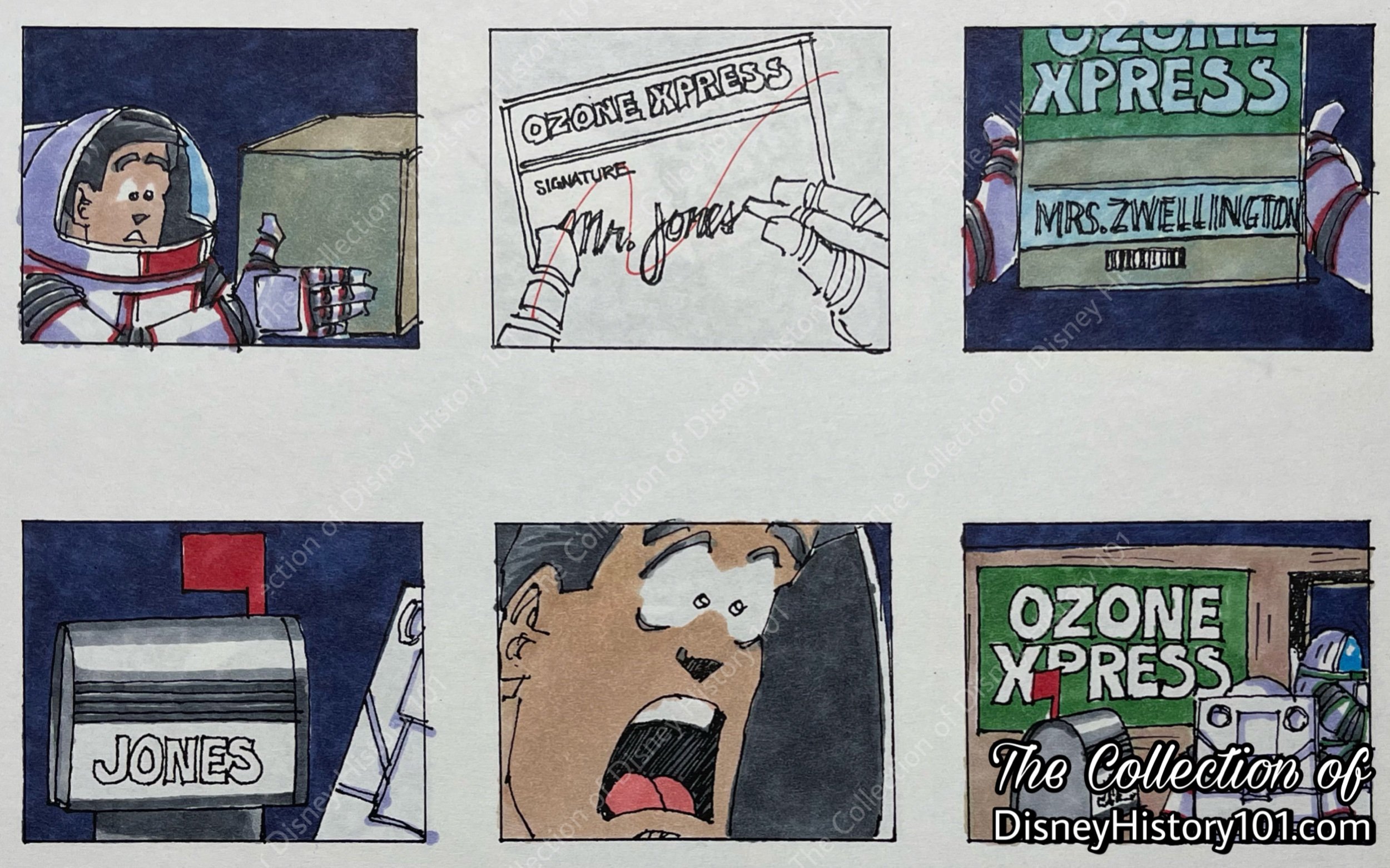
Here, an astronaut floats in deep space and desperately needs a package. The package is sent to the wrong address because the sender used “Ozone Express” instead of Federal Express.
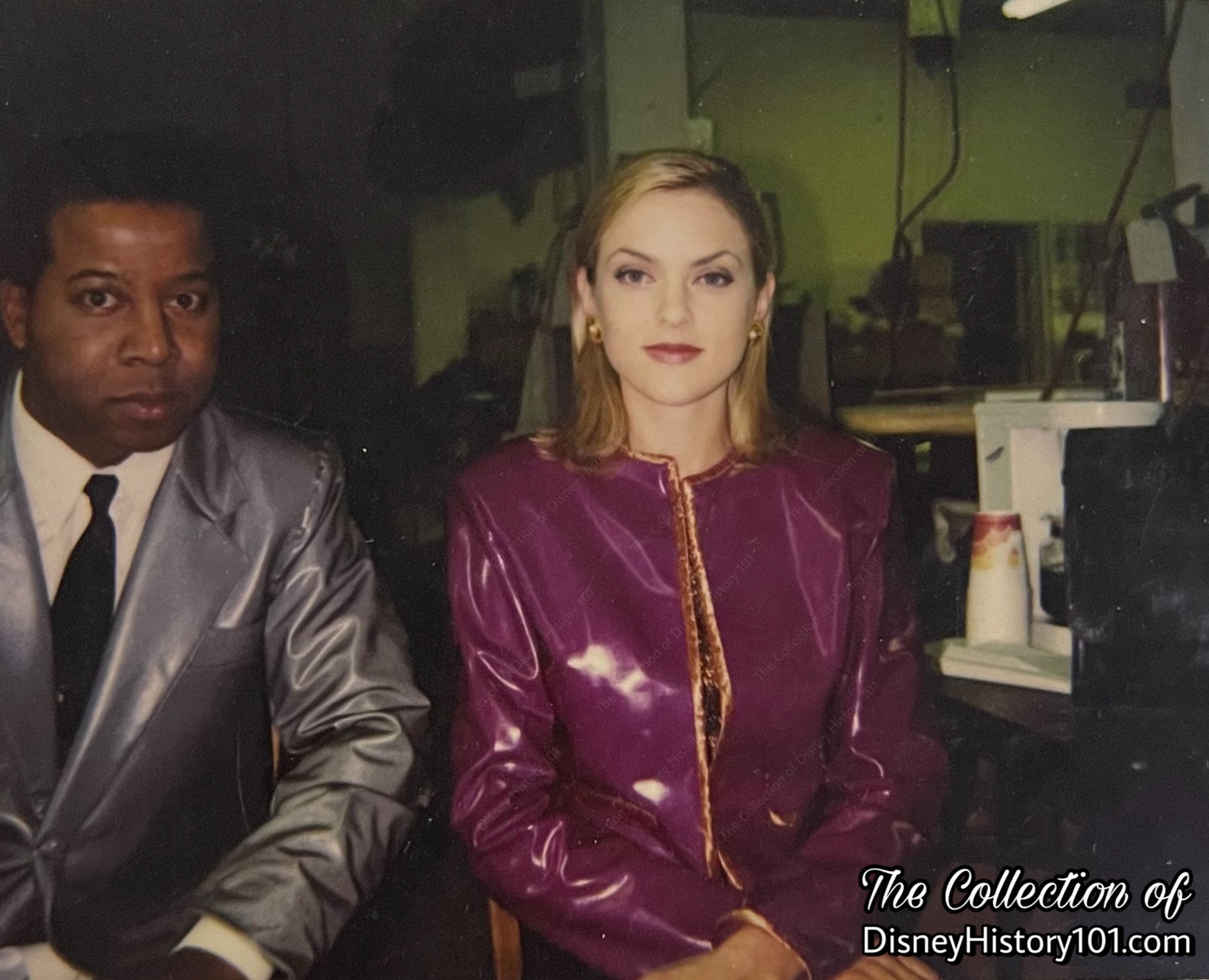
A number of talented actors and actresses appeared contributed to the short films. Mario Lopez (of “Saved by the Bell”) was the channel-surfing host in Mission Control, comedian Charles Fleischer performed the role of used satellite salesman Crazy Larry, with Glenn Shadix as fashion designer Ray Cathode and Kelly Coffield (of “In Living Color”) was transformed into weather caster Wendy Beryllium. The preceding Vintage View preserves a Backstage moment for Michael Carrington and Elaine Hendrix (of “Get Smart”) who portray the SMTV News Broadcasters Pam Pulsar and Dirk Tachyon as News Anchors of PNN. They weren’t the only celebrities to make an appearance, as the futuristic broadcast also included a statement by President Garco (the robot featured alongside Walt Disney in the c.1954 Disneyland episode “Mars and Beyond”).
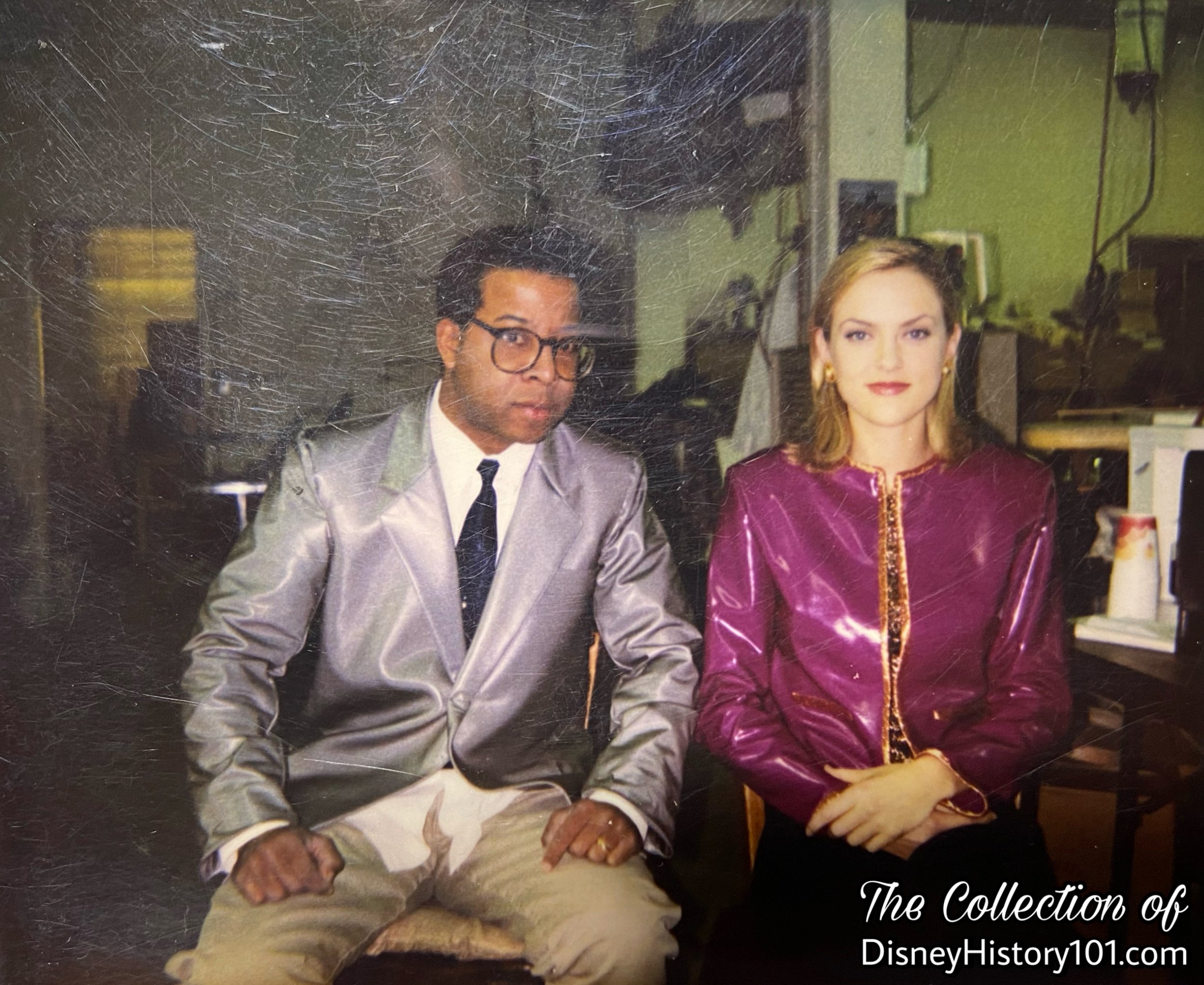
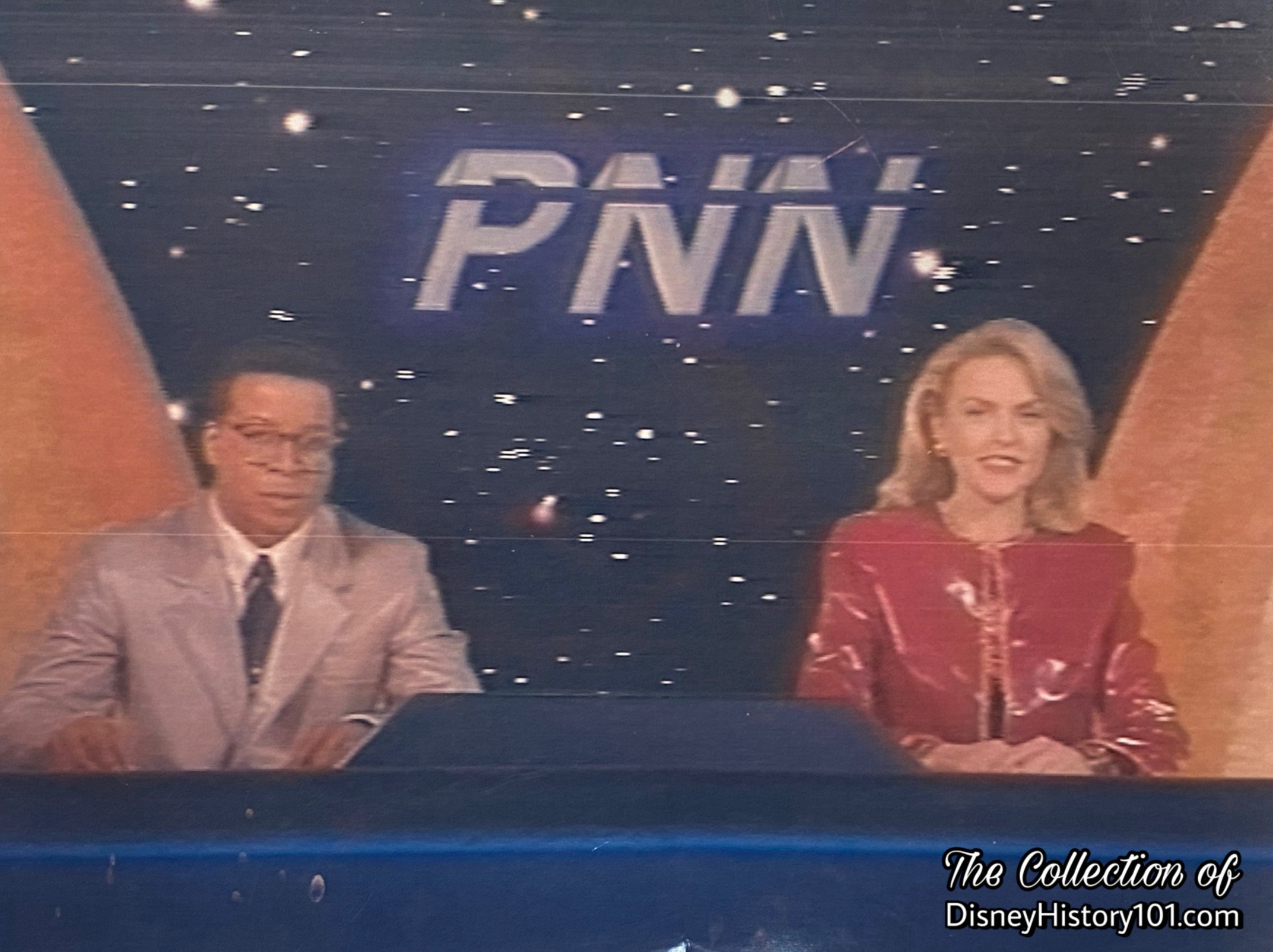
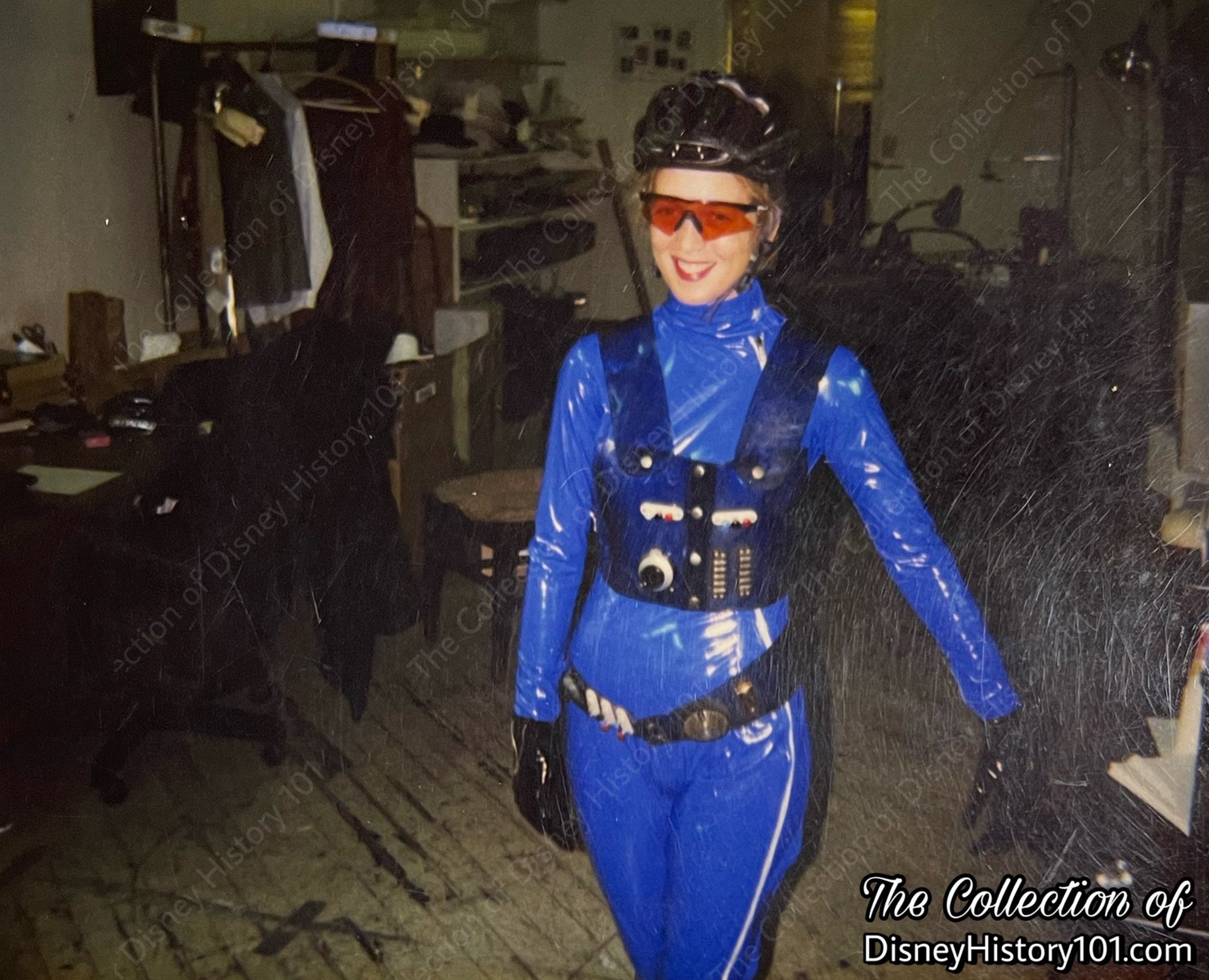
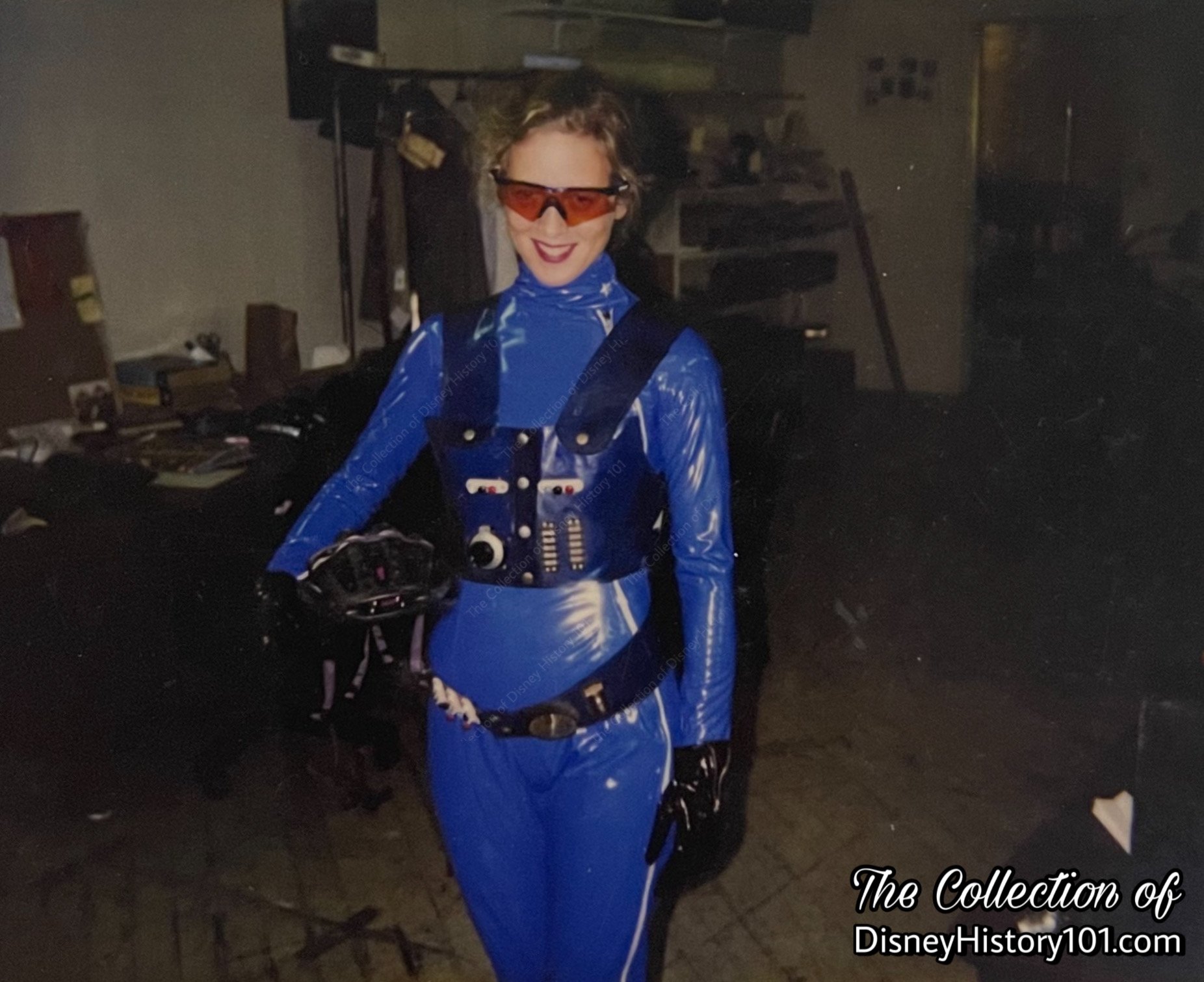
Costume Designer Colleen Atwood designed all the costumes for the SMTV video. This Vintage View preserves a costume fitting for actress Alexandra Wentworth (who had roles on Seinfeld and In Living Color) as Space Mountain Pan-Galactic News Network Reporter, Wendy Berrylium.
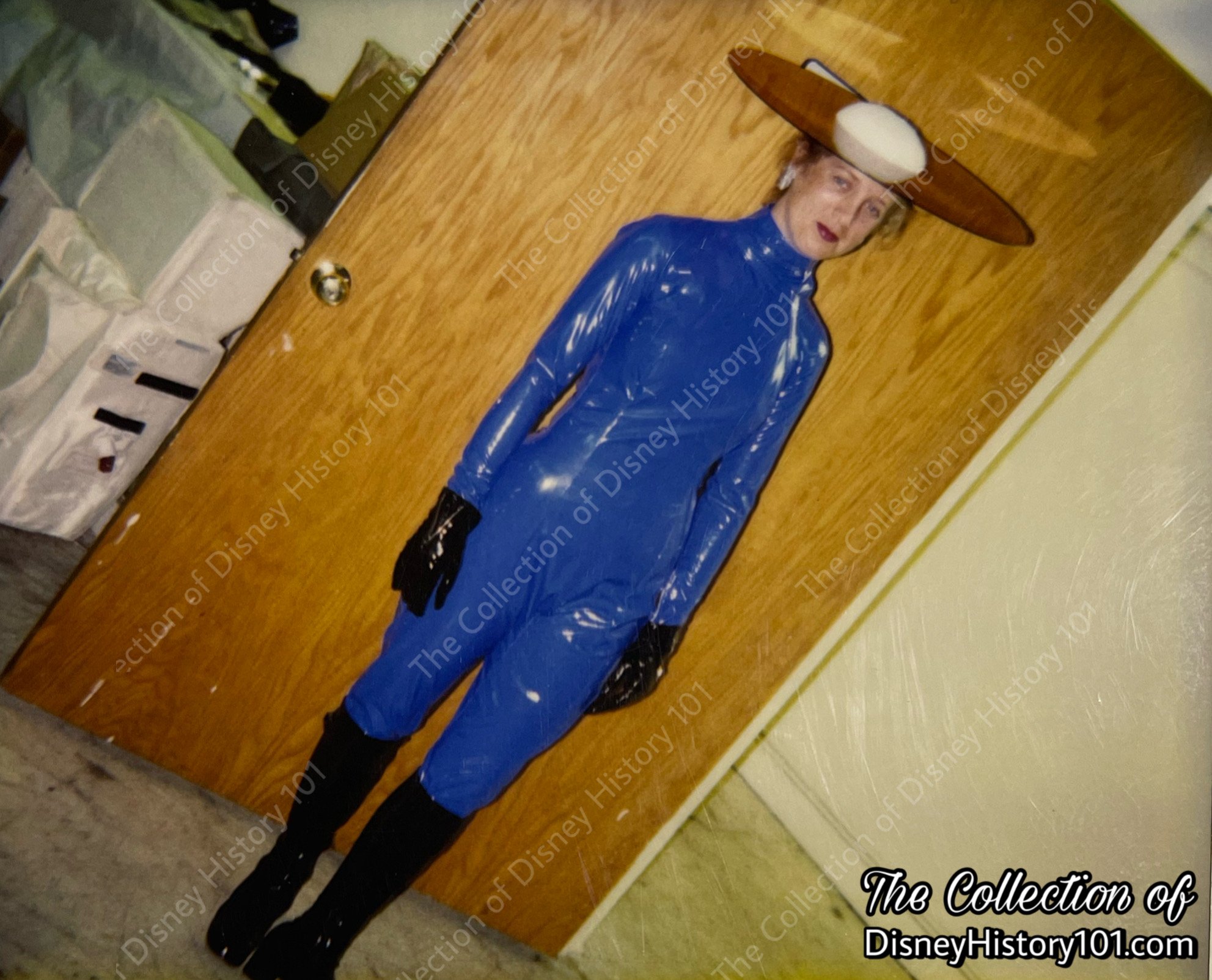
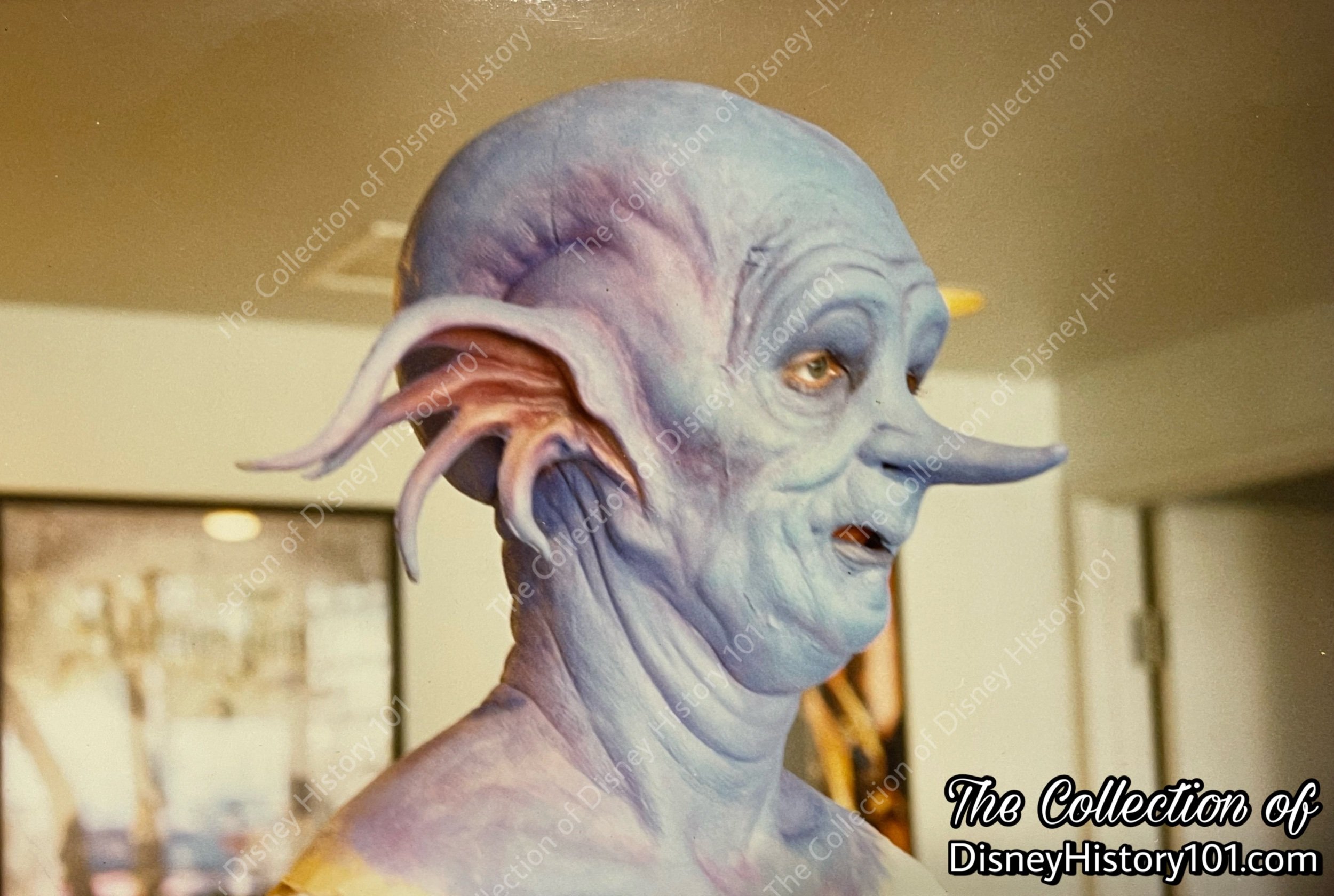
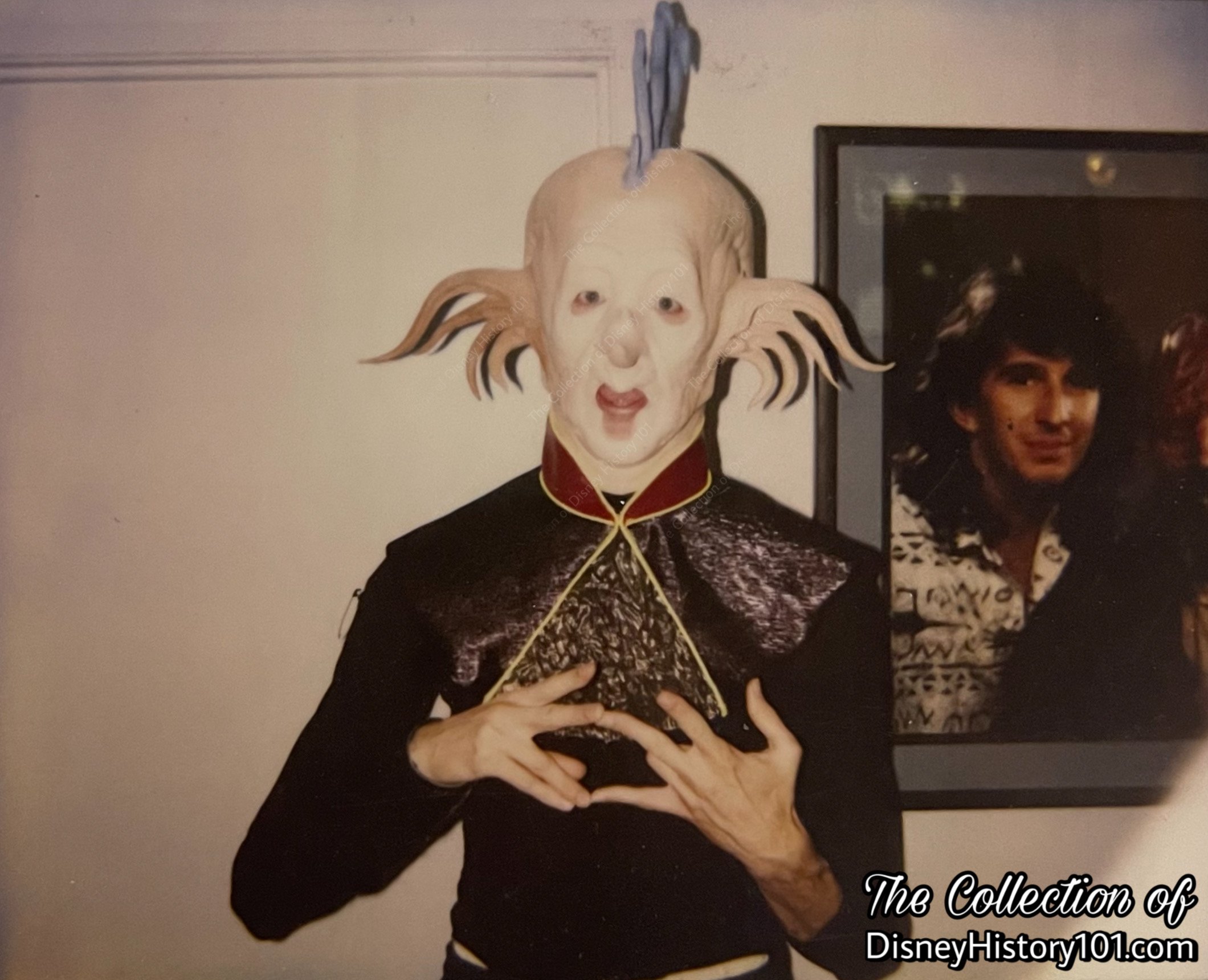
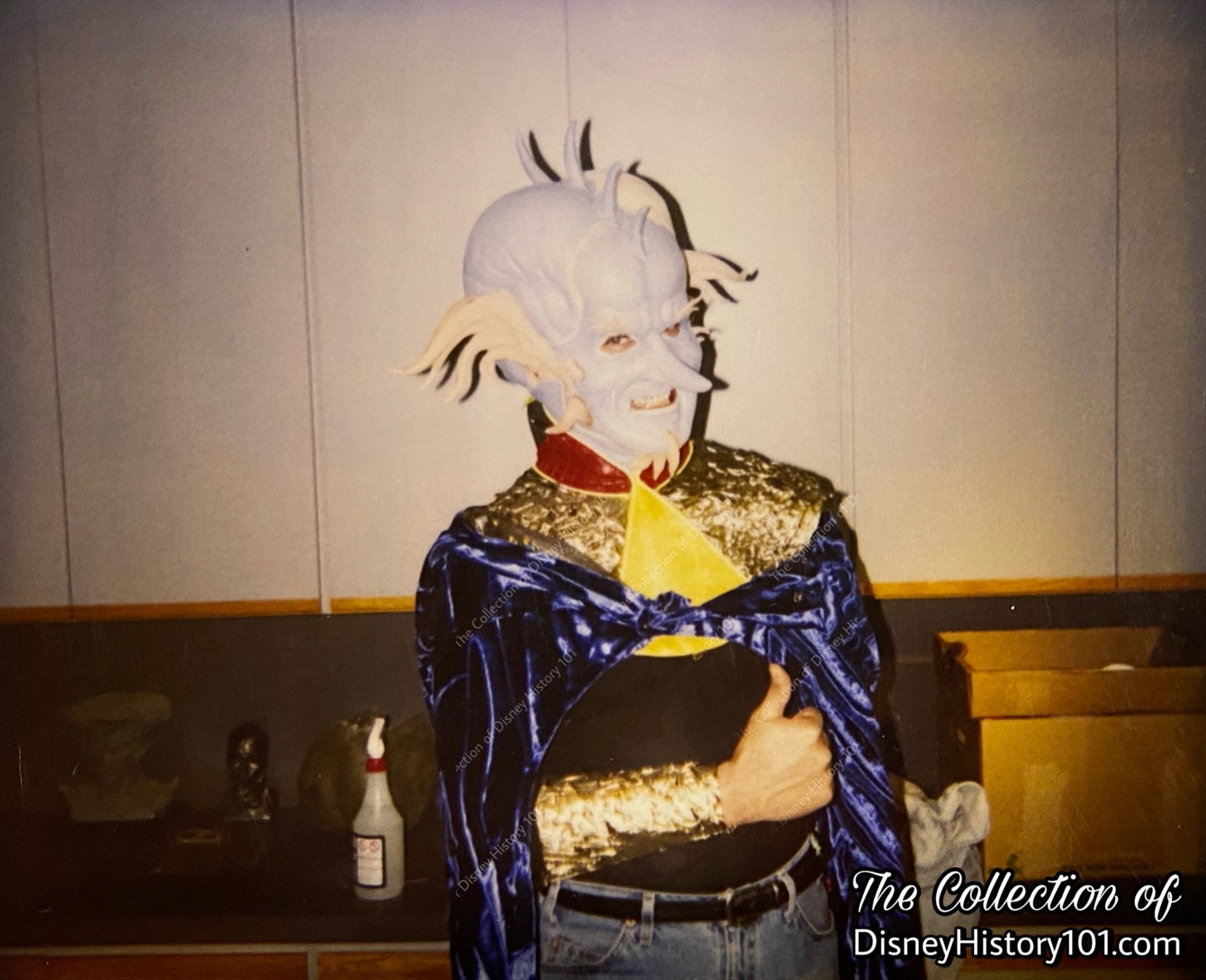
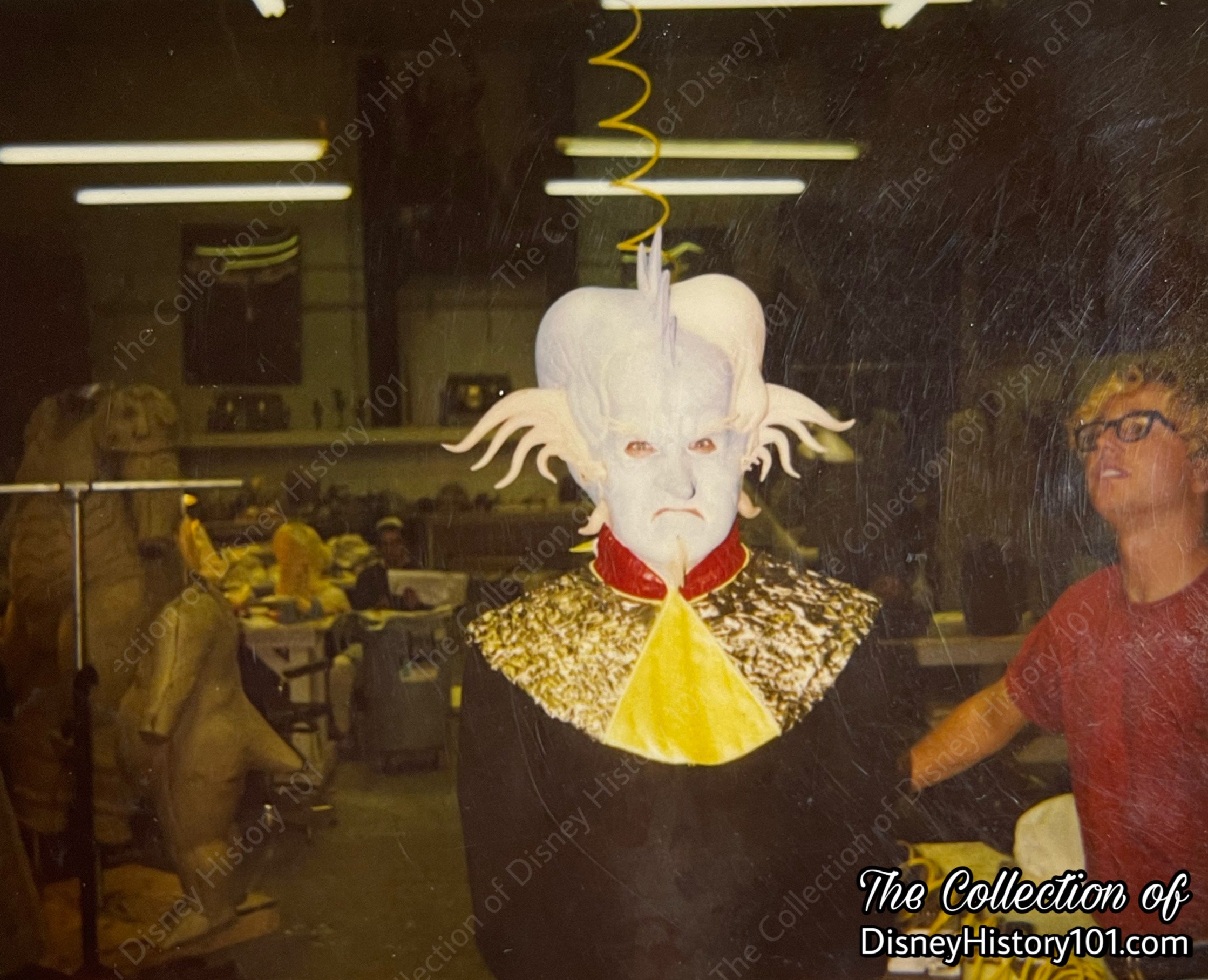
The “Wd Eye Openers” column (published August 15, 1995) gave a wonderful, detailed summary of production.
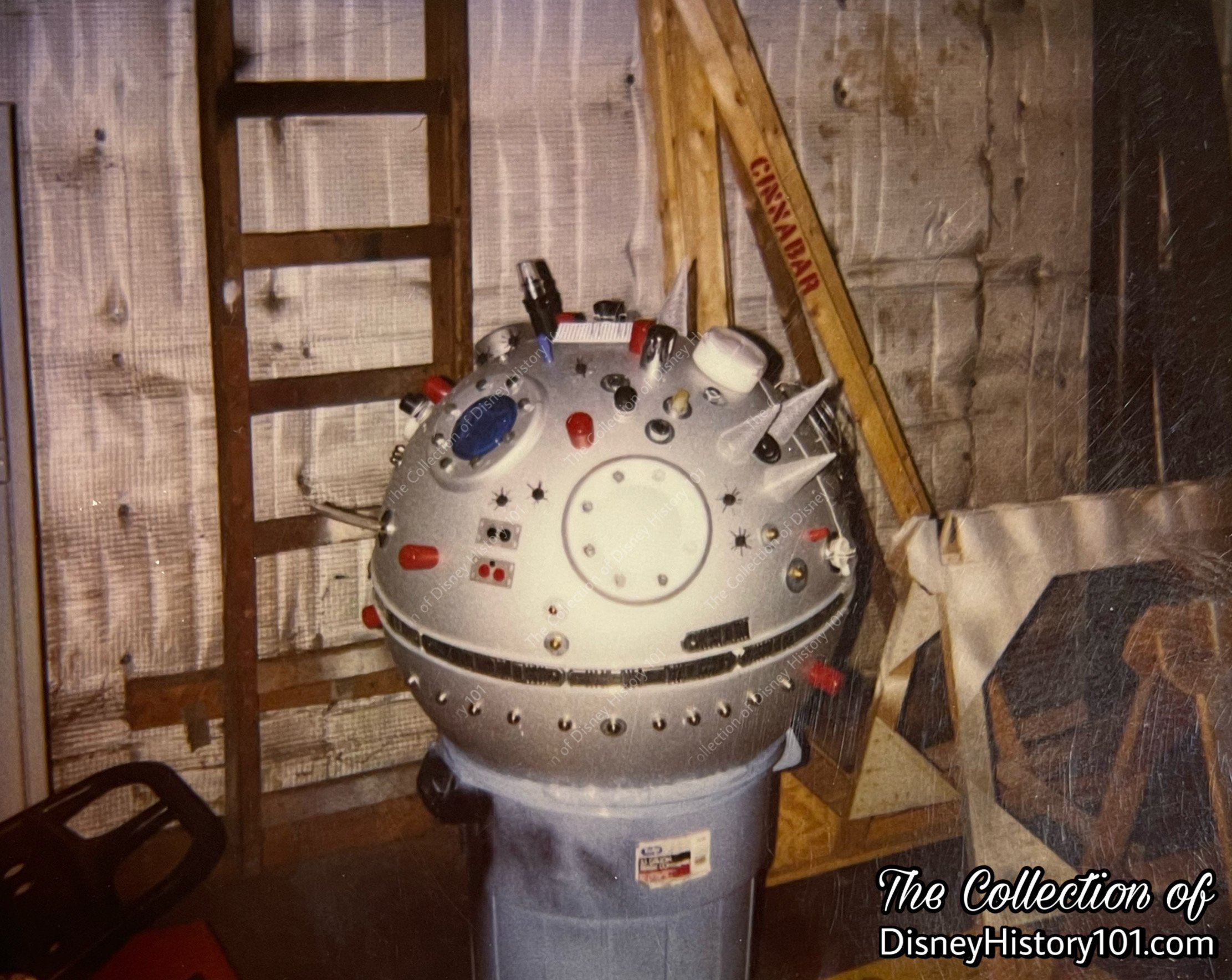
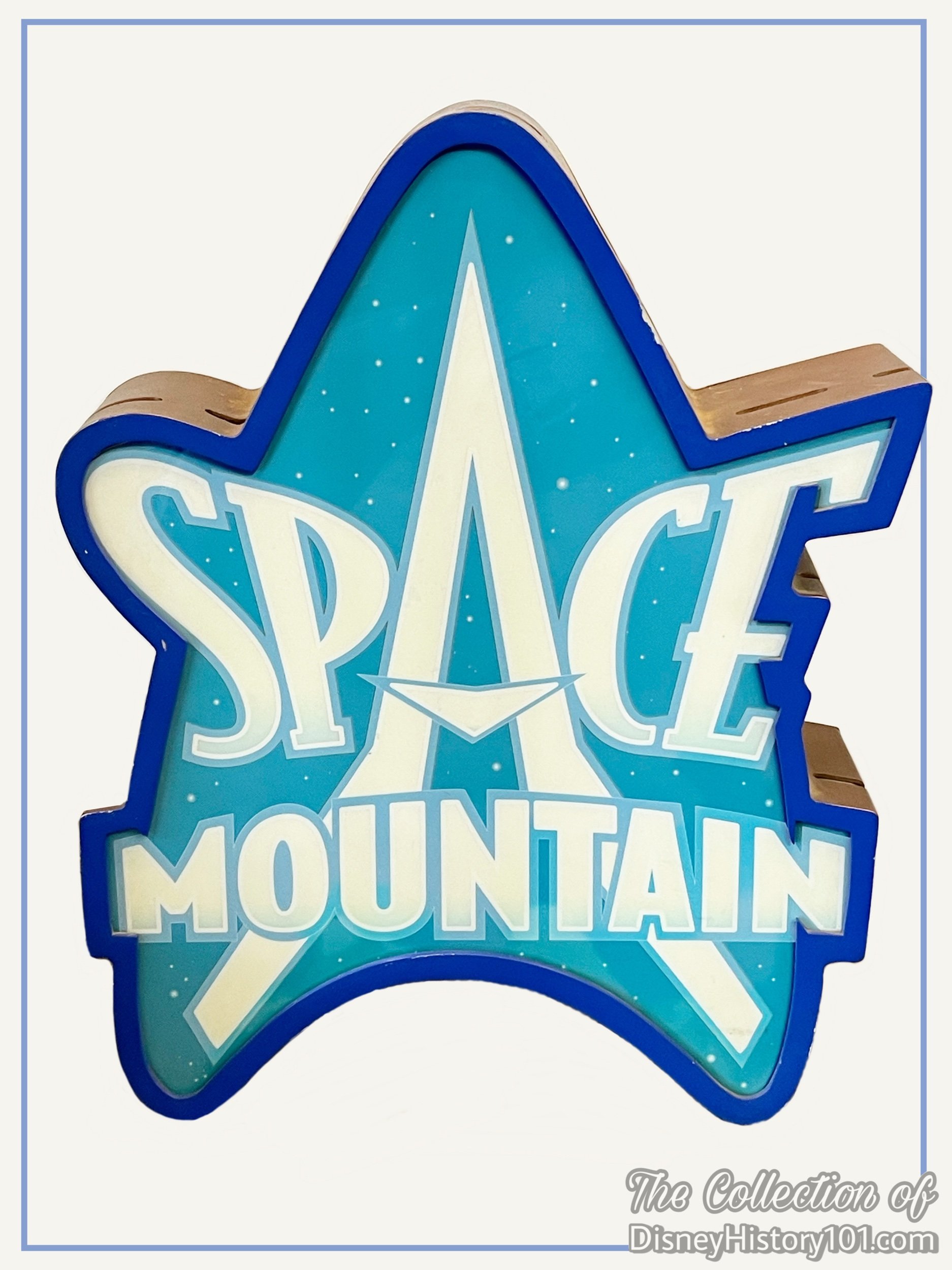
Beyond these years, both 1996 and 1997 were momentous for Space Mountain at Disneyland! In 1996, Dick Dale’s surfer sound descended upon the warp-speed roller coaster ride.
The following year (1997), many aesthetic changes occurred, altering the Show Quality of the building. Notably, a third ring was added to the roof of the Space Mountain Complex, and the Speed Ramp was removed during a massive Tomorrowland overhaul.
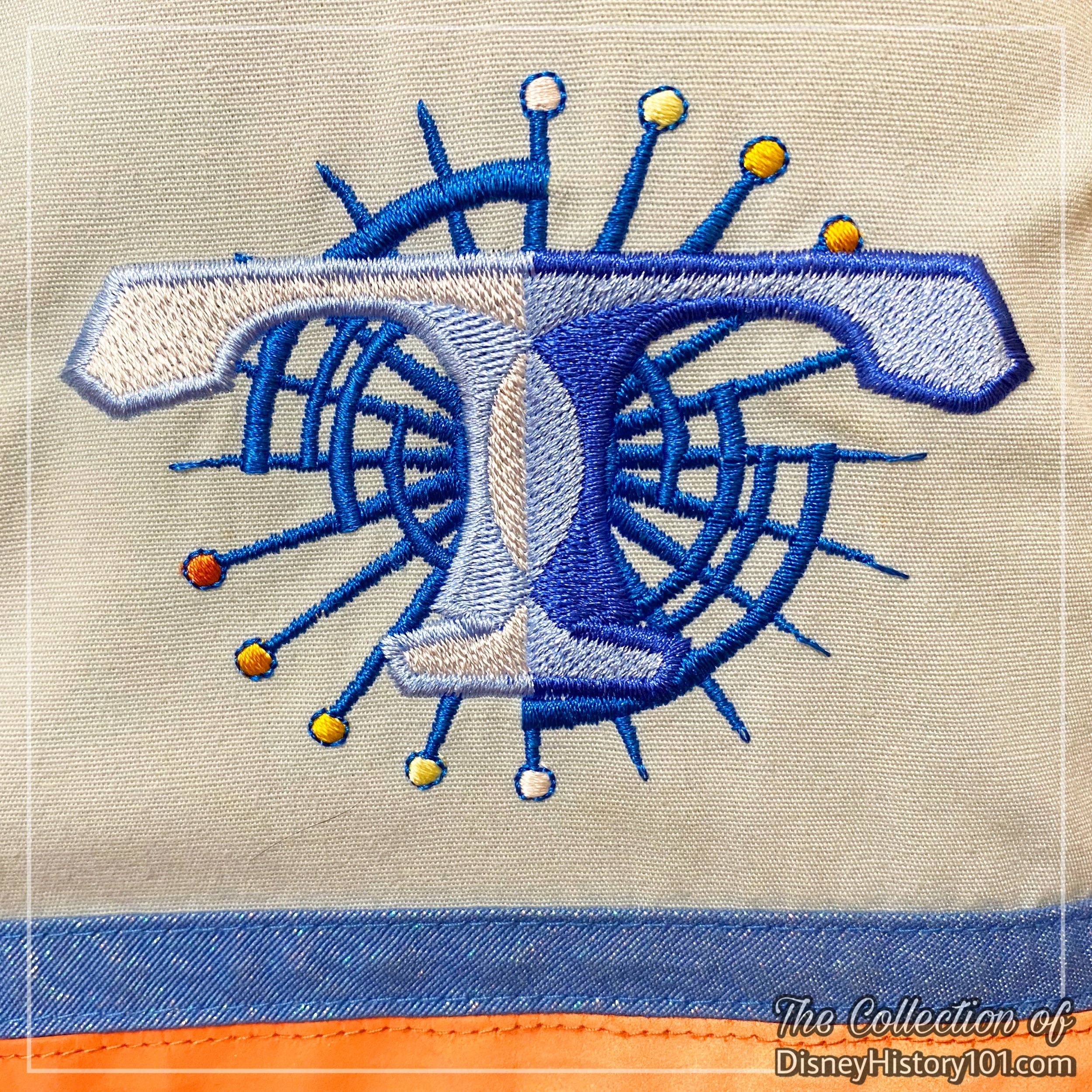
Ten years after FedEx became a Disneyland Participant (and after some renovation), Space Mountain would re-open (on July 15, 2005), with a “refurbished” brand-new track, new pre-Show scenes, an updated score (by Michael Giacchino) and a special ceremony attended by former astronaut Neil Armstrong.

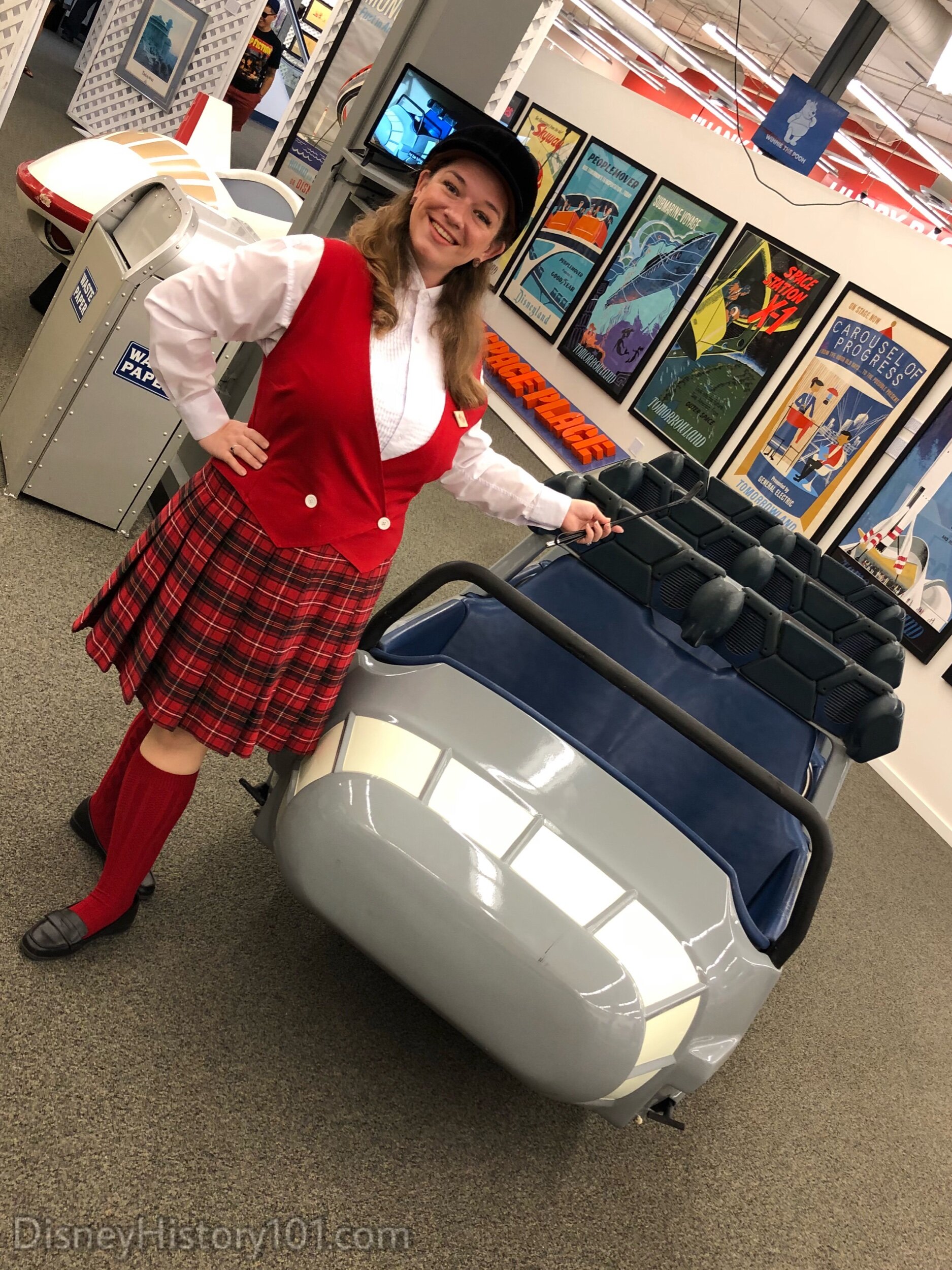
“Remove Vehicles” - In a historic (and frankly, never-to-be-repeated) auction, Van Eaton Galleries in conjunction with Richard Kraft offered the public a free show of rarely seen “Disneyana.” Among Richard Kraft’s former artifact collection at the “That’s From Disneyland” pre-auction museum show was one of the original twelve c.1977 Space Mountain Vehicles. Compared with those of the Walt Disney World Magic Kingdom, the new vehicles were streamlined and simplified, with a wider body, side-by-side seating for twelve passengers (as opposed to single-file seating for eight passengers). By 1984 a report revealed that a pair of Space Mountain tandem sleds weighed 2,300 lbs.
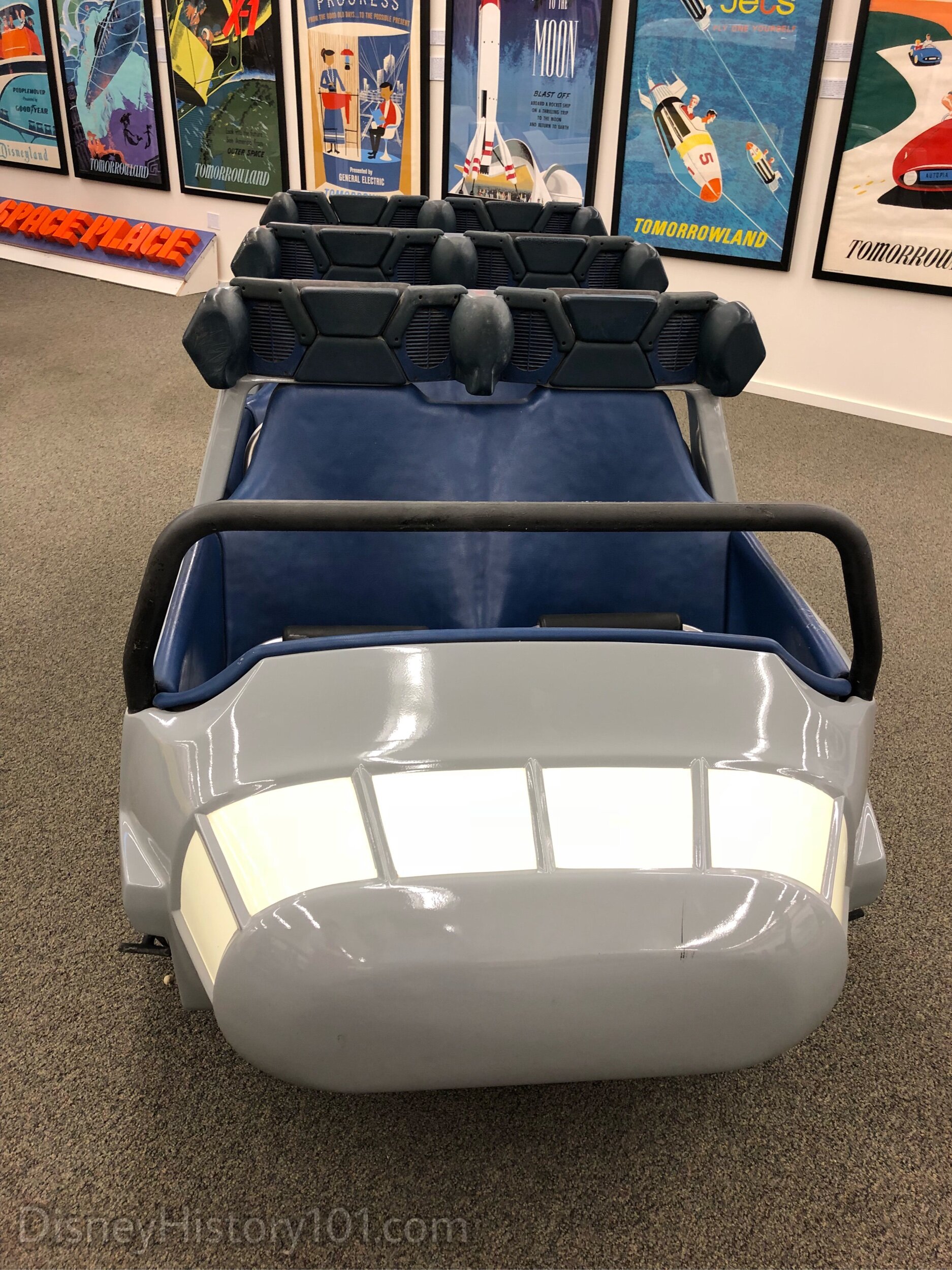
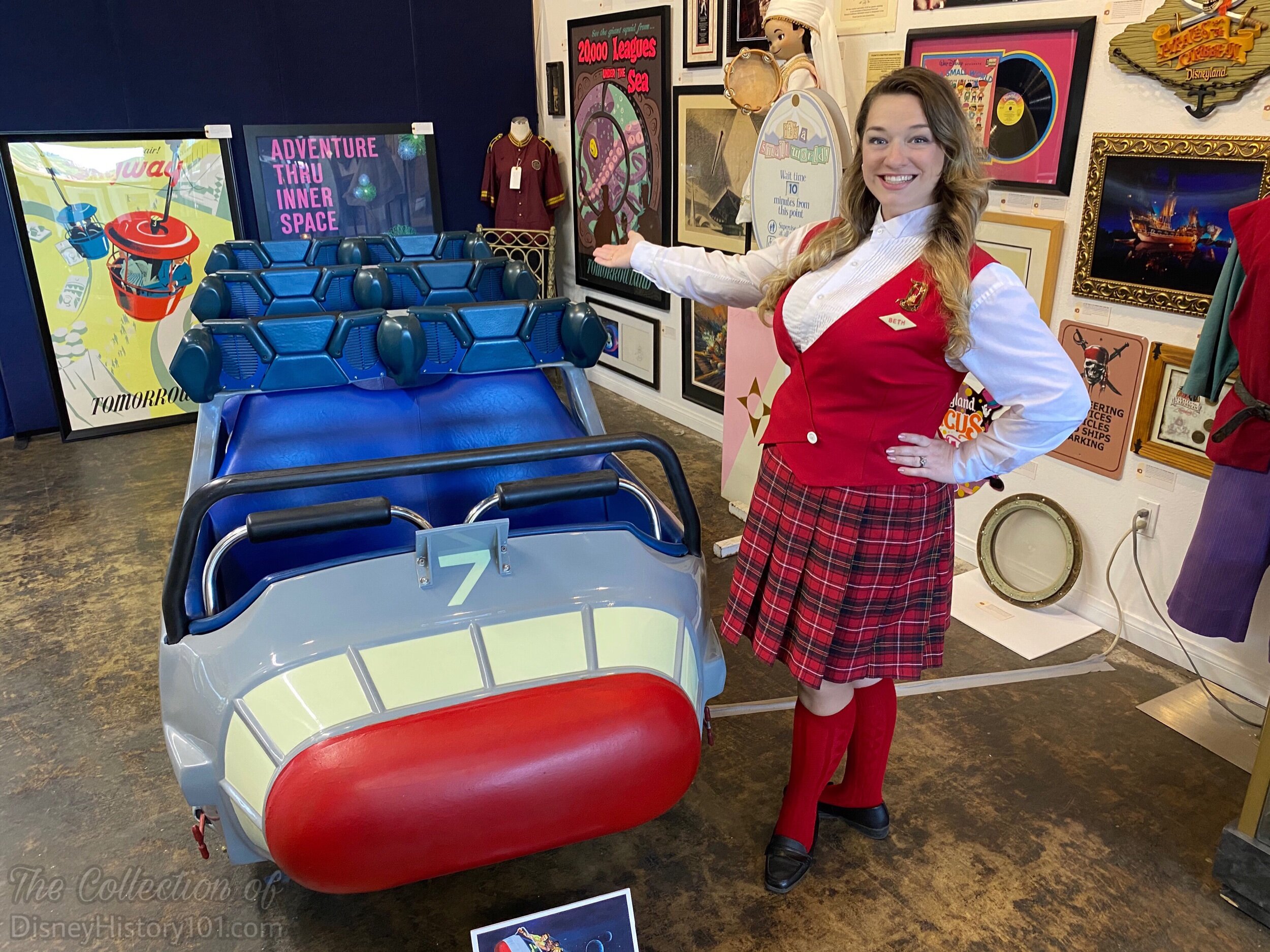
This is yet another original Space Mountain Vehicle that once shuttled guests through the reaches of the cosmos at “hyperspeed”. During 1996, Boston Acoustic speakers were installed that would only enhance the attraction’s Show Quality experience with a new onboard soundtrack. In 2020, one of these vehicles (with speakers) was auctioned off through Van Eaton Galleries, and became the property of a proud new owner.
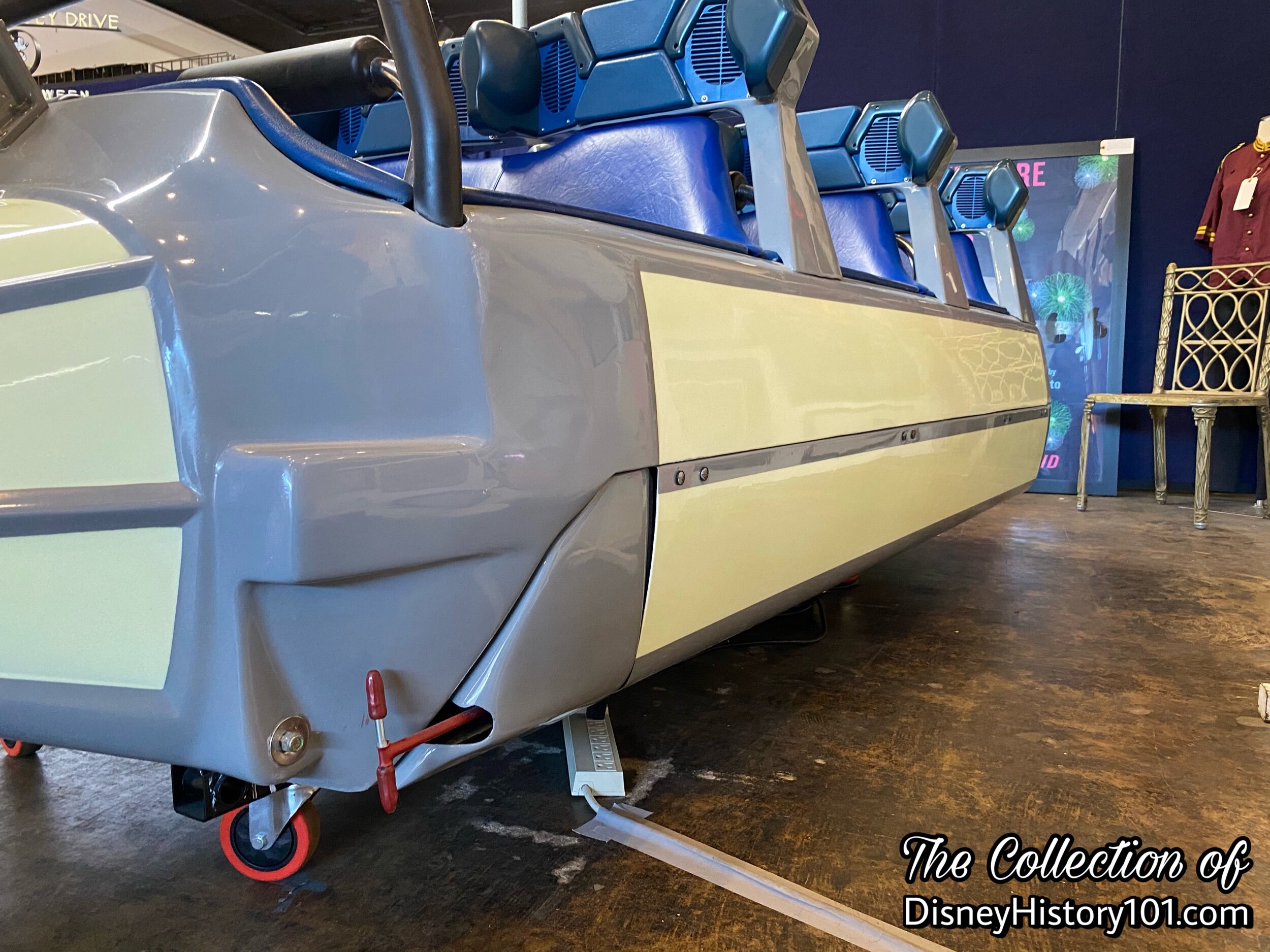
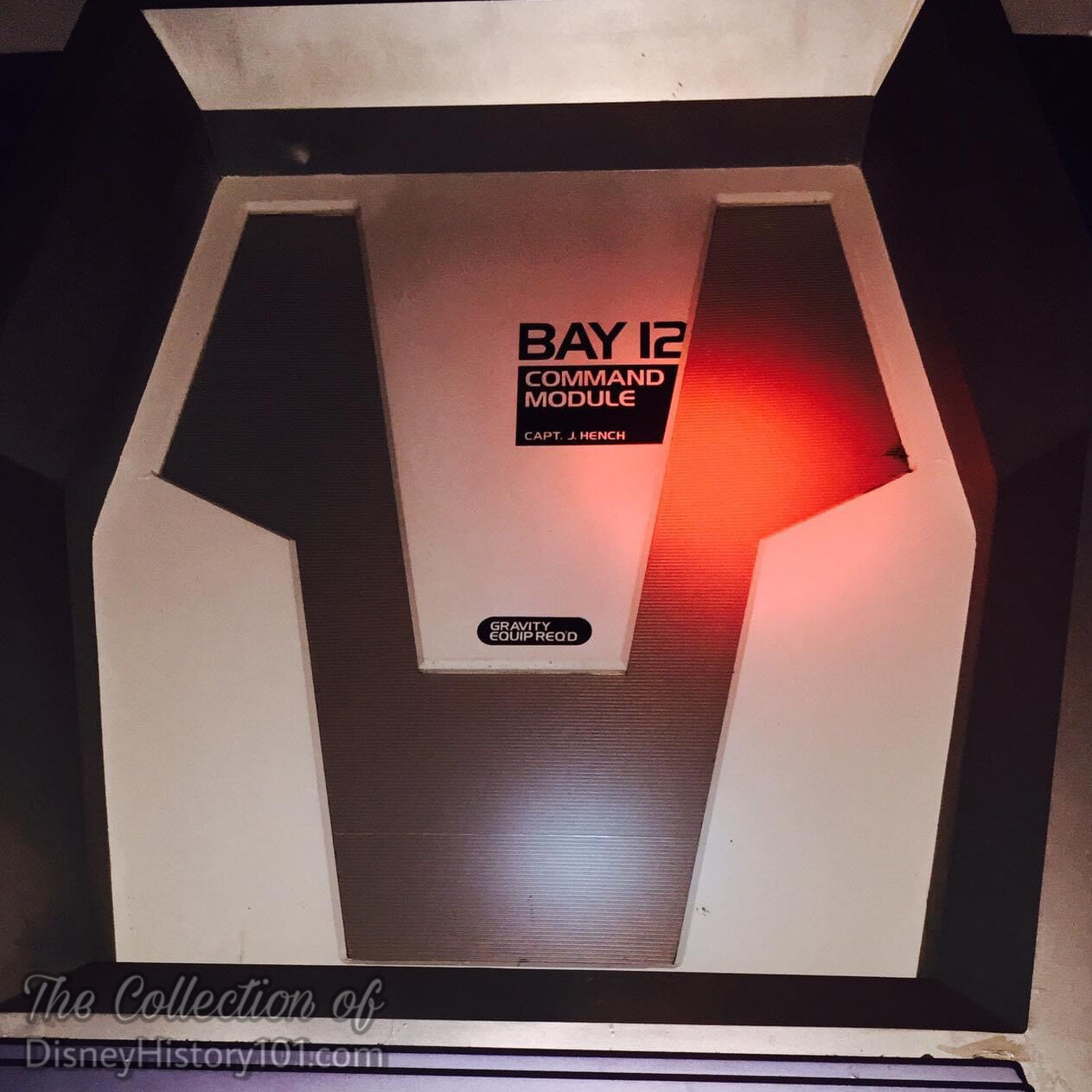
Which brings us to our final “sidelight.” Inside Space Mountain (just above a Decompression Supplies Hatch, along the queue), is another hatch appropriately labelled, “Bay 12, Command Module, Captain John Hench.” This is appropriate, as John Hench (the longest-termed Disneyland employee, at 64 years with the company) first created concepts for Tomorrowland, and then assisted in re-designs of Tomorrowland (in 1967 and 1998). Two years after Space Mountain opened, John assumed the title of WED Enterprises Senior Vice President on September 17, 1979. John helped develop many shows and attractions for Disneyland, and was “instrumental in master-planning every Disney park world-wide, actively involving himself in show concepts, architecture, costumes, graphics and every other aspect of design.” But most important were his contributions toward the towering Space Mountain!
Marty remembered Hench as a “mentor”: “John Hench was the most articulate and well-read person that ive ever worked with and he encouraged me in so many ways.” It is of note to the credit of John’s humble character: “John Hench, an original Imagineer with WED, told Marty [Sklar], ‘When we get finished with a project, you or none of us can say, ‘I did that, I did this, because we all did it, so many hands touched it, changed it and made it better, that it's a we, it's never an I.’”
By 2003, the Space Mountain had a legacy in Tomorrowland at Honk Kong Disneyland. A prospectus describes: “A warp-speed adventure to the far reaches of the universe and back. Guests board 12-passenger ‘rockets’ that streak at white-knuckle speeds through a meteor shower. Each vehicle has an on-board sound system that synchronizes music and sound effects with the racing rocket.” The complex would also have a concourse, “a futuristic garden area between Space Mountain and Buzz Lightyear Astro Blasters that serves as a rest spot for weary intergalactic travelers in Tomorrowland. Shade trees, benches and unique water elements enhance the park-like environs.”
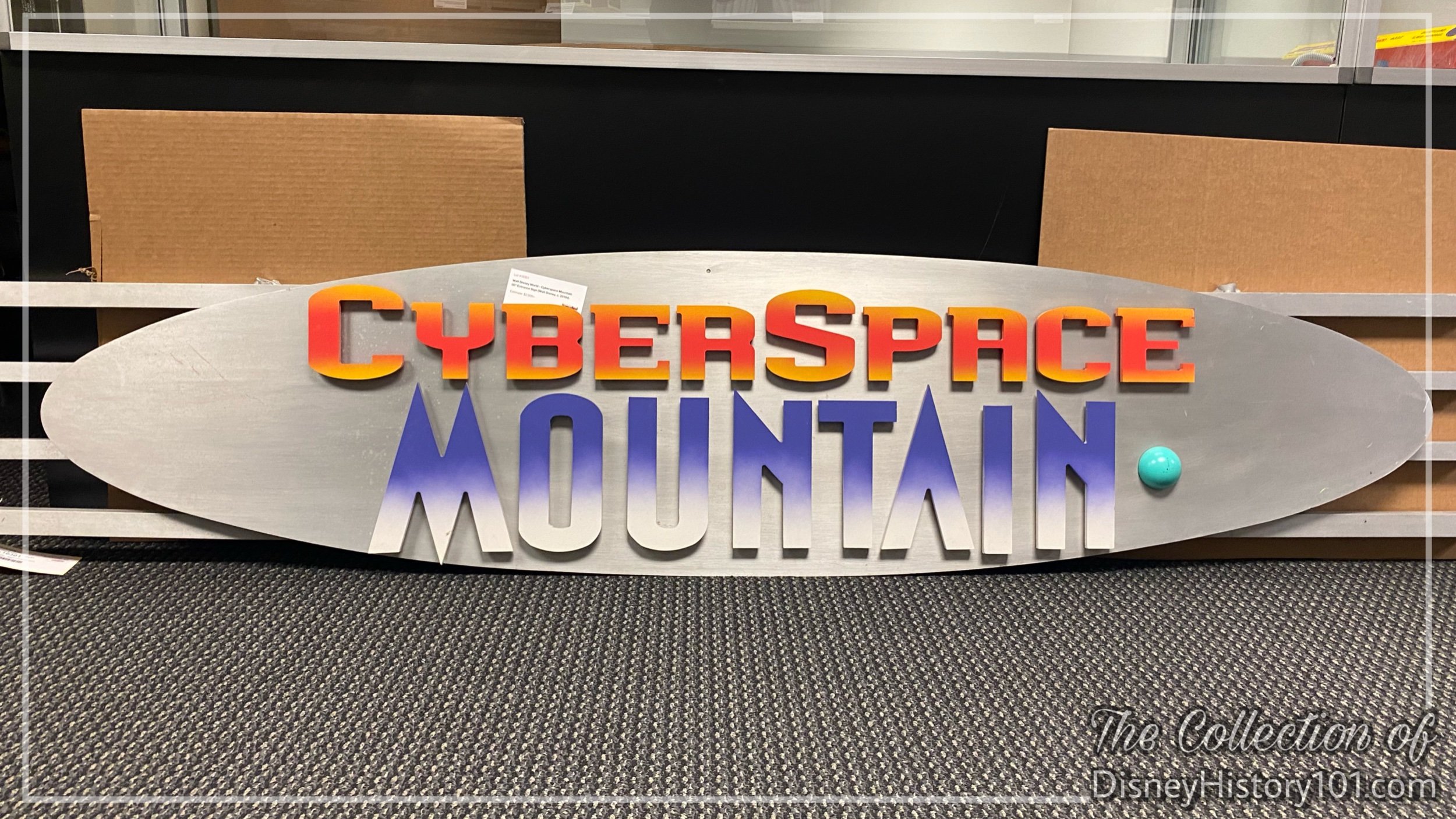
Then there was CyberSpace Mountain at DisneyQuest in Downtown Disney, allowing Guests to design their very own rollercoaster.
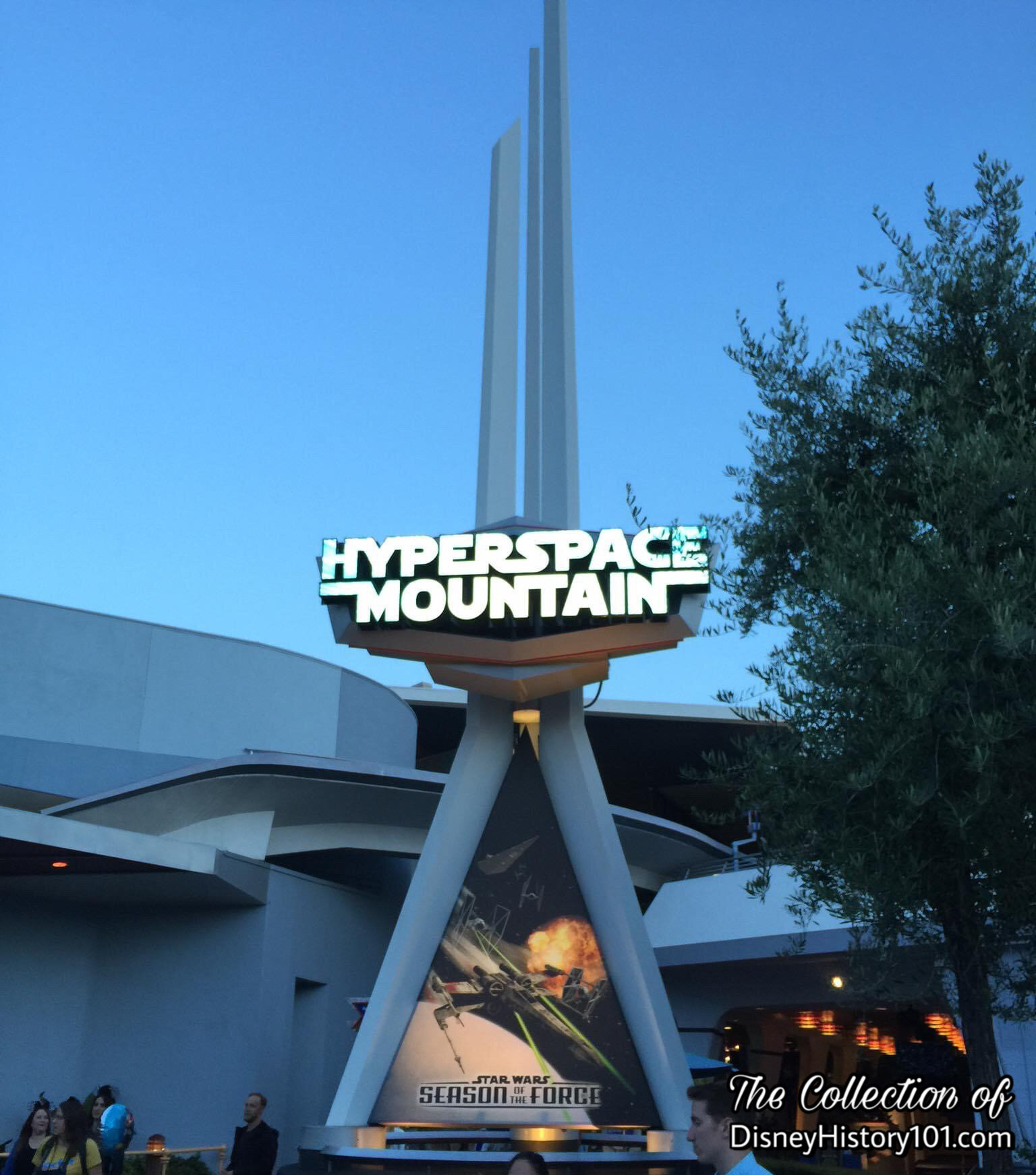
Since the beginning, the Four Keys of the DISNEYLAND Show (operating priorities in presenting the DISNEYLAND Show) have been present - Courtesy, Safety, Show, and Efficiency. Guided by these Four Keys, are Walt Disney Imagineers, who are always seeking out new magical opportunities to increase the efficiency, safety, and show quality of Disneyland adventures. This being the case, Walt Disney Imagineers are constantly seeking to improve upon the show of Tomorrowland and one of its most popular attractions - Space Mountain! During the 1990s, Tim Delaney (of Walt Disney Imagineering Creative Development) created concepts of a Star Wars inspired Death Star overlay for Space Mountain. In 2008, WDI master plans entertained the concept of an update to the Space Mountain Show Building, Forecourt and “HISTA” involving some sort of Global 3-D technology.
On July 15, 2005, Space Mountain was relaunched with a new generation of special effects, state-of-the-art show elements, new rocket vehicles, and an upgraded sound system, featuring an all-new audio track. The opening ceremony took place at 10AM and the attraction was open to guests at 11 AM.
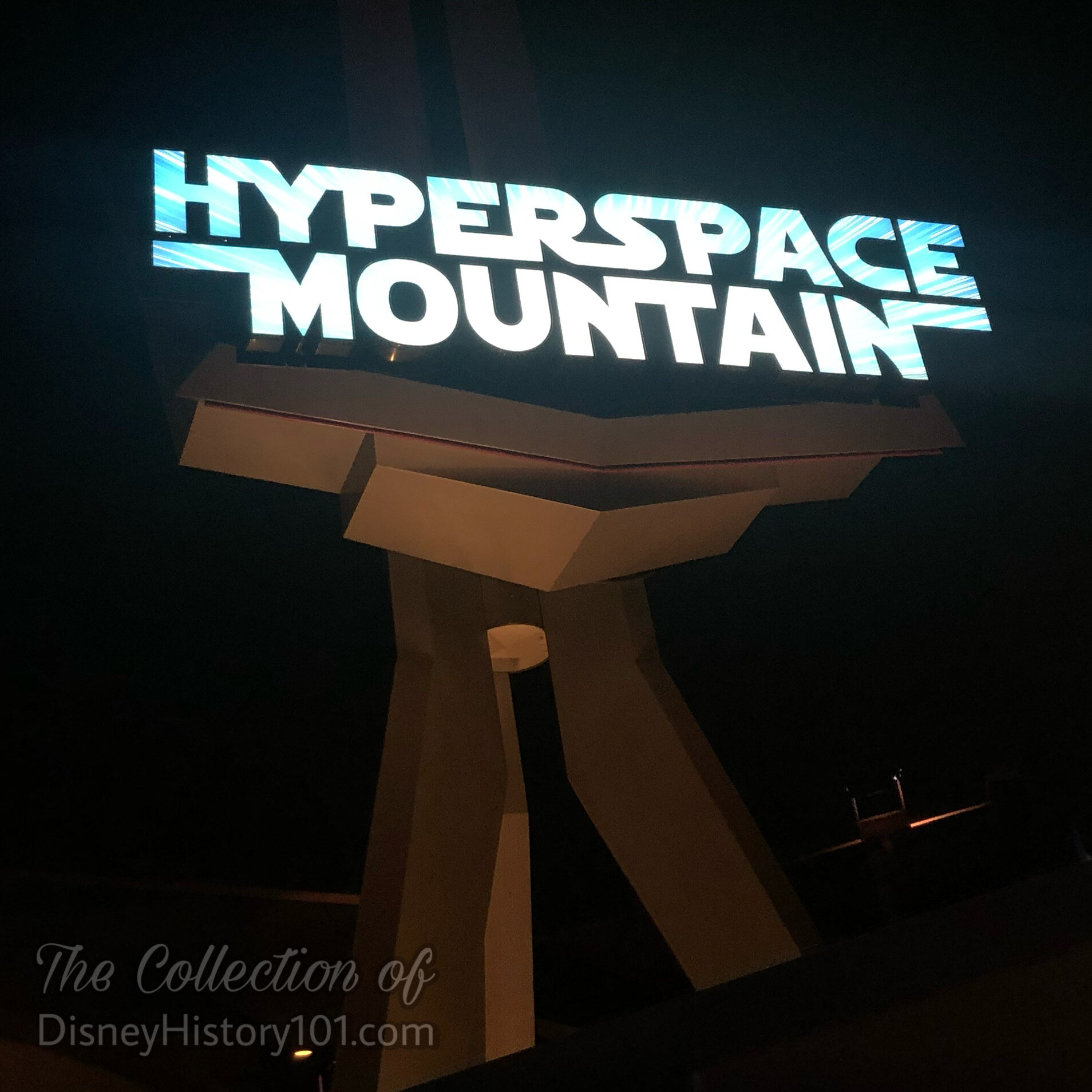
There have been many “Overlays” to Space Mountain over the years, like borrowing “Ghost Galaxy” from Hong Kong. A few years later, the Space Mountain Show was temporarily changed for the spring of 2016, when a new Star Wars inspired adventure started a tradition of temporary seasonal ride refurbishments! After being launched into hyperspace, shuttles jump right out of hyperspace travel, and into battle with several tie fighters and a star destroyer in Hyperspace Mountain! In 2017, Hong Kong Disneyland carried the Hyperspace Mountain tradition, as Guests dodge blaster fire and dash through a raging dogfight between Rebel X-wing Starfighters and Imperial TIE fighters.
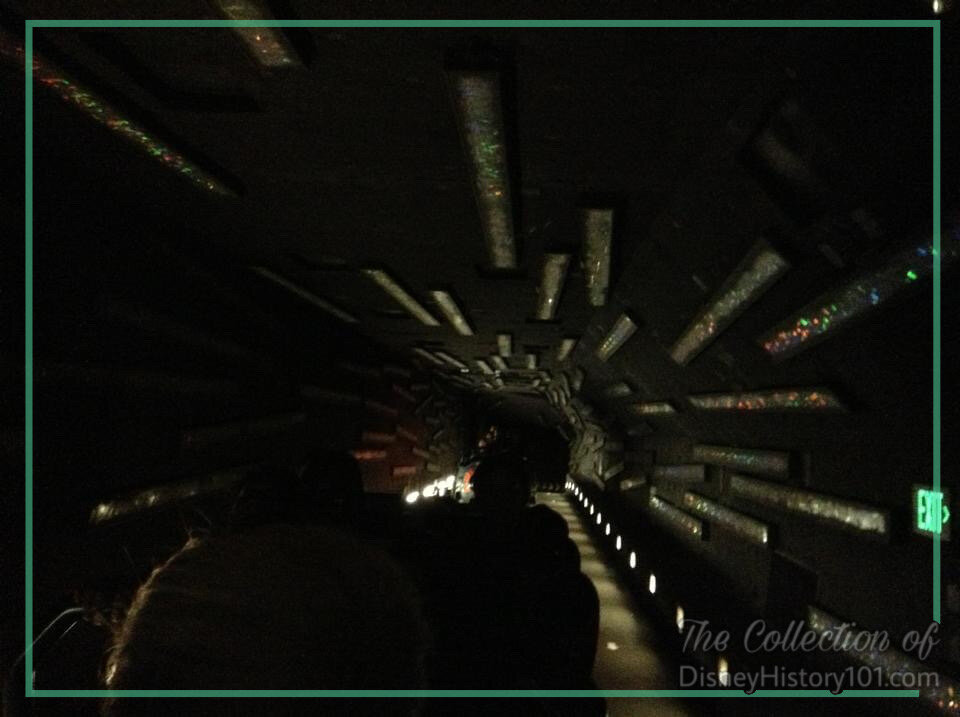
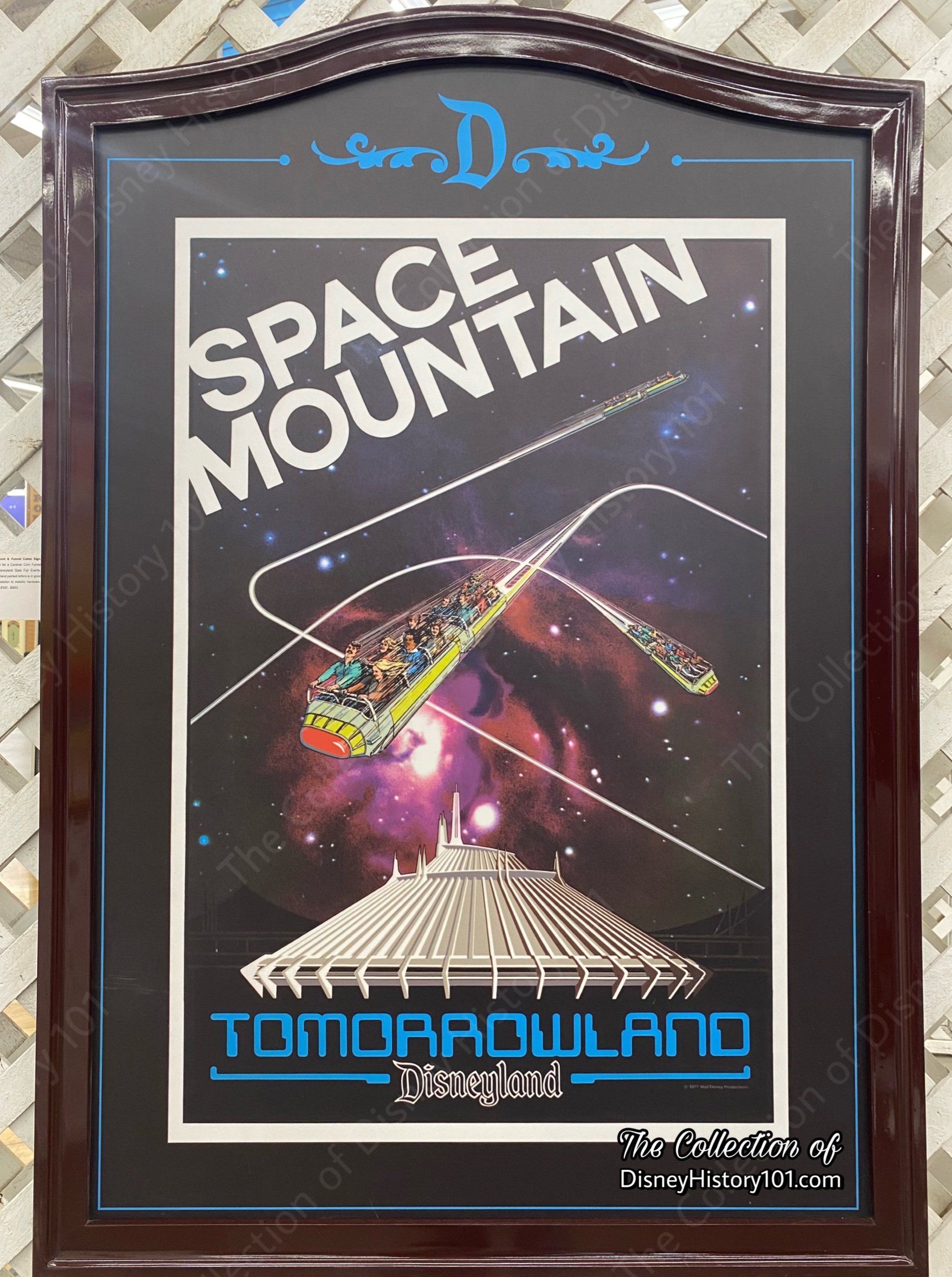
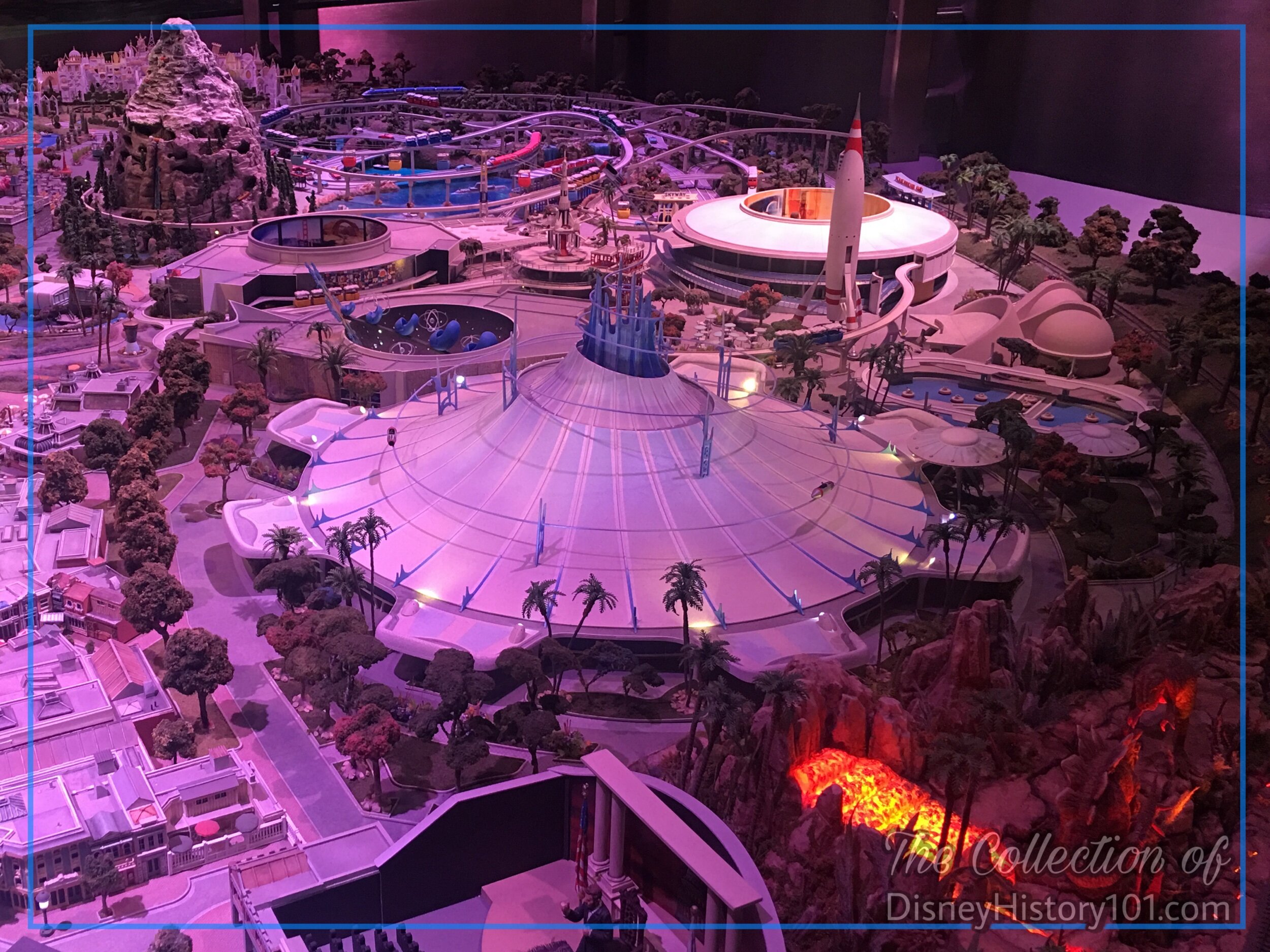
While new “Overlays” add new dimensions of adventure to Space Mountain, there’s at least one location where guests can enjoy the Space Mountain of John Hench’s imagination (at least, in miniature form) - The Walt Disney Family Museum in San Francisco, California!
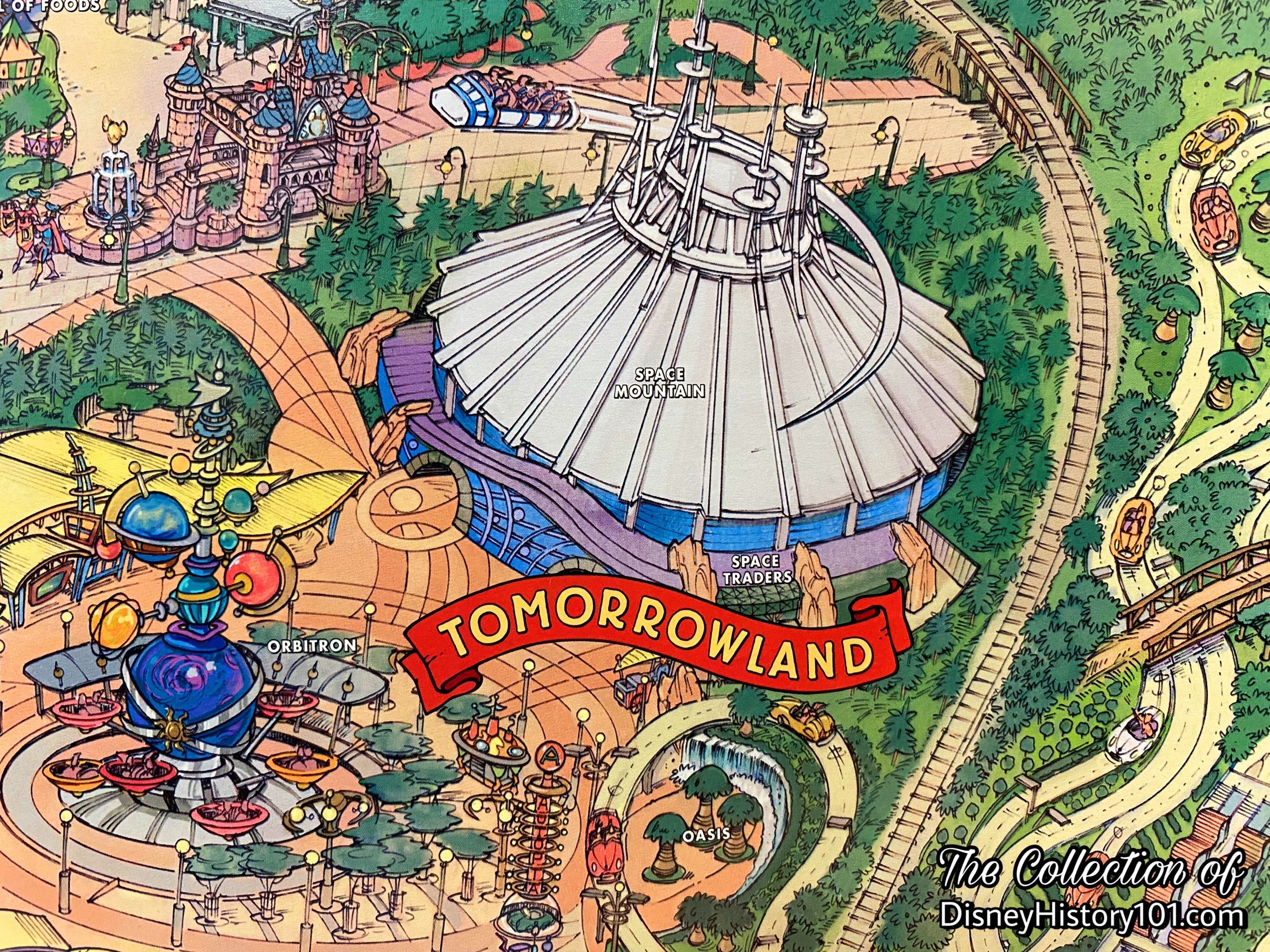
THE SPACE PLACE
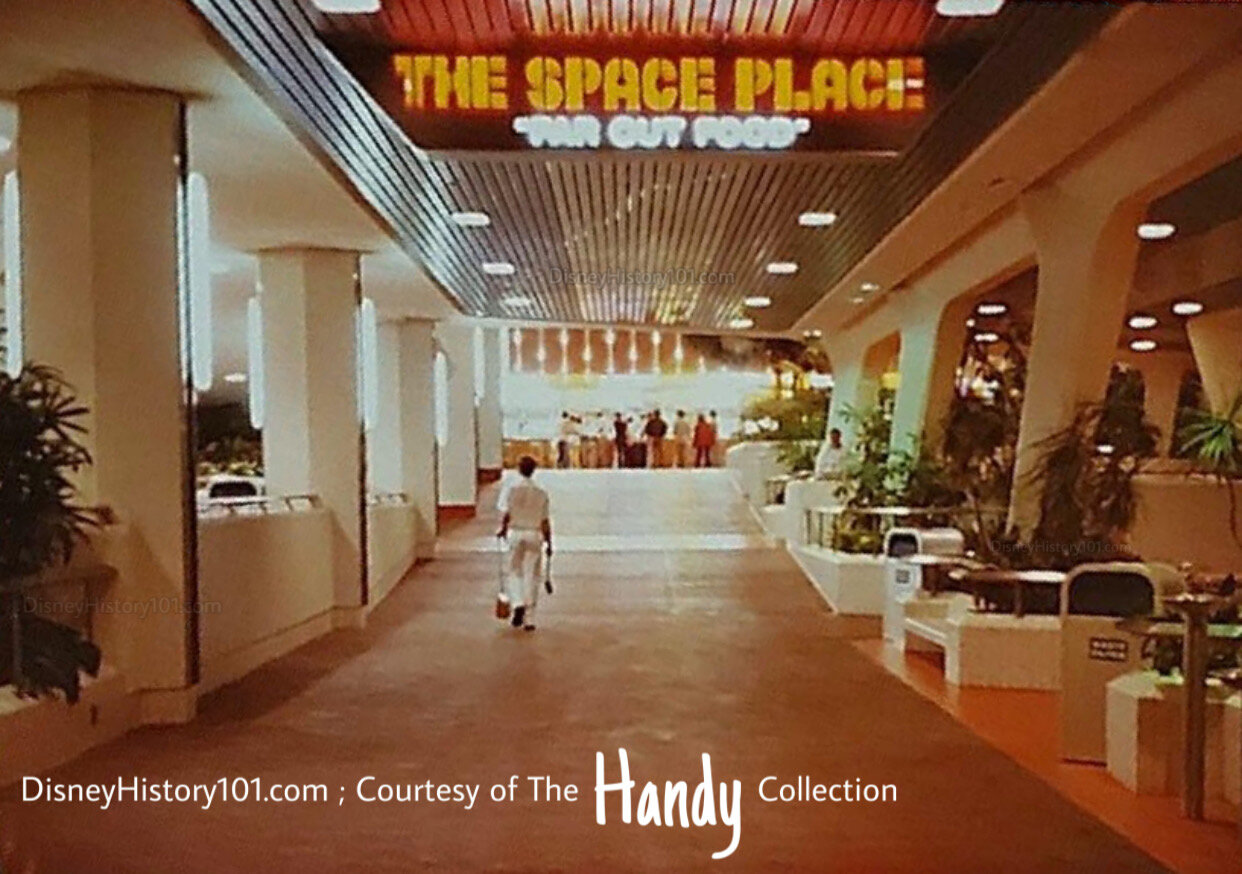

This efficient, elevated, 670-seat Space Place quick service location over Tomorrowland was the place to go for “far out foods”! The counter-service area (located on the lower level), offered a array of menu options (including pizza, hotdogs, salads, and ice creams). While many guests will recall that the Space Place was host to “Space Place Character Lunch” daily until 4p.m., Cast Members will often recall service from the Space Place Cast Member Window.
While Park guests dined, many attractions of Tomorrowland (like the PeopleMovers in an enclosed fiberglass tunnel), could be seen from the Space Place’s upper dining area. The lower level along the East Promenade offered a view of the entertainment on the Space Stage Bandstand and dancing on in the Space Stage Forecourt.
The Space Place’s private open-air patio could be rented for special group parties (like birthdays), when it wasn’t being used to host special Tomorrowland events. For example, The Space Place was the place to celebrate Mickey’s Birthday Party (during the winter of 1984) and Disneyland’s Official 30th Birthday Party daily (at 11am and 7pm) throughout 1985. Disney characters started the celebration at every table with cake, a beverage (like punch), a Mickey Mouse balloon, and a button - like an official 30th year or Birthday button - for each guest (at $2.50 per person). The Space Place was also used (the following year), as a Media Lounge for reporters, during the Captain EO opening ceremonies! With the adjacent Space Stage, there was aways a fresh supply of live sounds resonating though the terrace.
As happening as things were, the majority of the Space Place was ultimately replaced by the Toy Story Funhouse (a temporary Pixar feature film promotion), and eventually Redd Rocket’s Pizza Port. In the present, the Space Place ordering area has been re-purposed as a Fast Pass Distribution Center, while the upper dining area has been refurbished to act as Space Mountain’s queue. The Space Place has a legacy though - Tokyo Disneyland has a restaurant named Space Place FoodPort! For now, let’s take a look back at this unique nook nestled Tomorrowland’s most happening zone!
By 1981, the Space Place offered a number of menu options named after shuttles:
•Gemini - Chicken & Chips (chicken fried to a golden brown served with french fries and gelatin.)
•Mariner - Fish & Chips (fish fillets fried to a golden brown served with french fries and gelatin.)
•Apollo - Super Dog (quarter-pound hot dog served with french fries.)
•Mercury - Chicken Sandwich (breaded chicken breast fried to a golden brown served on a roll.)
The Tomorrowland fast food location also had one of the most extensive dessert menus offering Gelatin, Turnover, Layer Cake, Ice Cream Sundaes (chocolate and strawberry), Ice Cream Cones (soft swirl - chocolate, vanilla and chocolate/vanilla swirl), Ice Cream Sandwich, Ice Cream Bar, Frozen Banana, and the Thick Frosty Milk Shakes (in chocolate, strawberry, or vanilla).
By 1984, Space Place featured chicken, fish in a basket, chicken fillet sandwich, meatball sandwich, hot dogs, soft-service cones and sundaes.
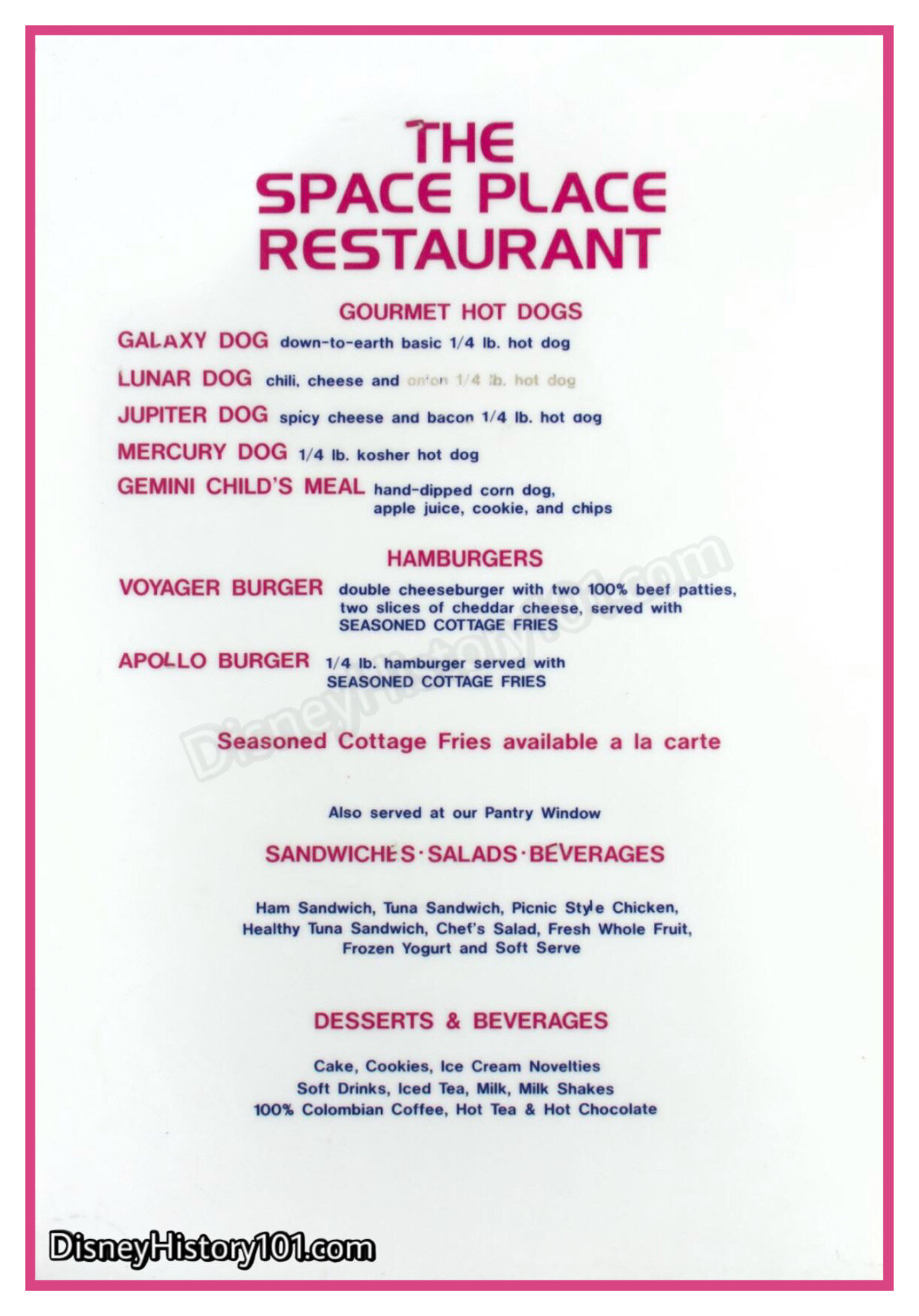
The menu of the Space Place stayed mostly consistent thru the decades, as seen on this 1990’s menu! By 1990, healthier menu alternatives - Tuna Sandwich made with cholesterol-free oil, Chef’s Salad, Garden Salad, and Frozen Yogurt - were made available to guests!

“I was hired as a float driver for America on Parade. When that ended we did odd jobs in entertainment, like go-fers for sound and lighting crews. I once delivered a cup of hot coffee to a rooftop spotlight guy by climbing up a ladder!
The parade job was over and our time in entertainment was limited hours. I needed something more, applied, and foods was all they offered. But it got me "in the park".
I . . . worked in Space Place for 1 year. I began right when it opened 1977 as a transfer from entertainment. I remember a Lead named Karla who worked us hard, but taught us about work ethics. We were never idle. There was always something we could be doing: cleaning, stocking, prepping. That may be a Foods thing and not a Karla thing, but I attribute it to her.
Employees were treated well (lots of perks, softball leagues, canoe races, tickets for the park, etc) They worked around college schedules, trained us well, and pay was good. It wasn't always easy, especially dealing with unpleasant guests and sometimes weather, but it was a great 8 years for me.
I was at Space Place when Space Mountain opened in 1977. Employees had multiple opportunities to ride before it officially opened to the public. Listening to Papa Doo Run Run was one [other perk]. The bass player liked ice tea [and would order it from the Space Place]. We had an employee window, too, and got to see friends there... [Also], the chocolate cake was amazing. It was an excellent experience overall.”

We’ll make our way just under the newly installed Speedramp, and to the Space Place!
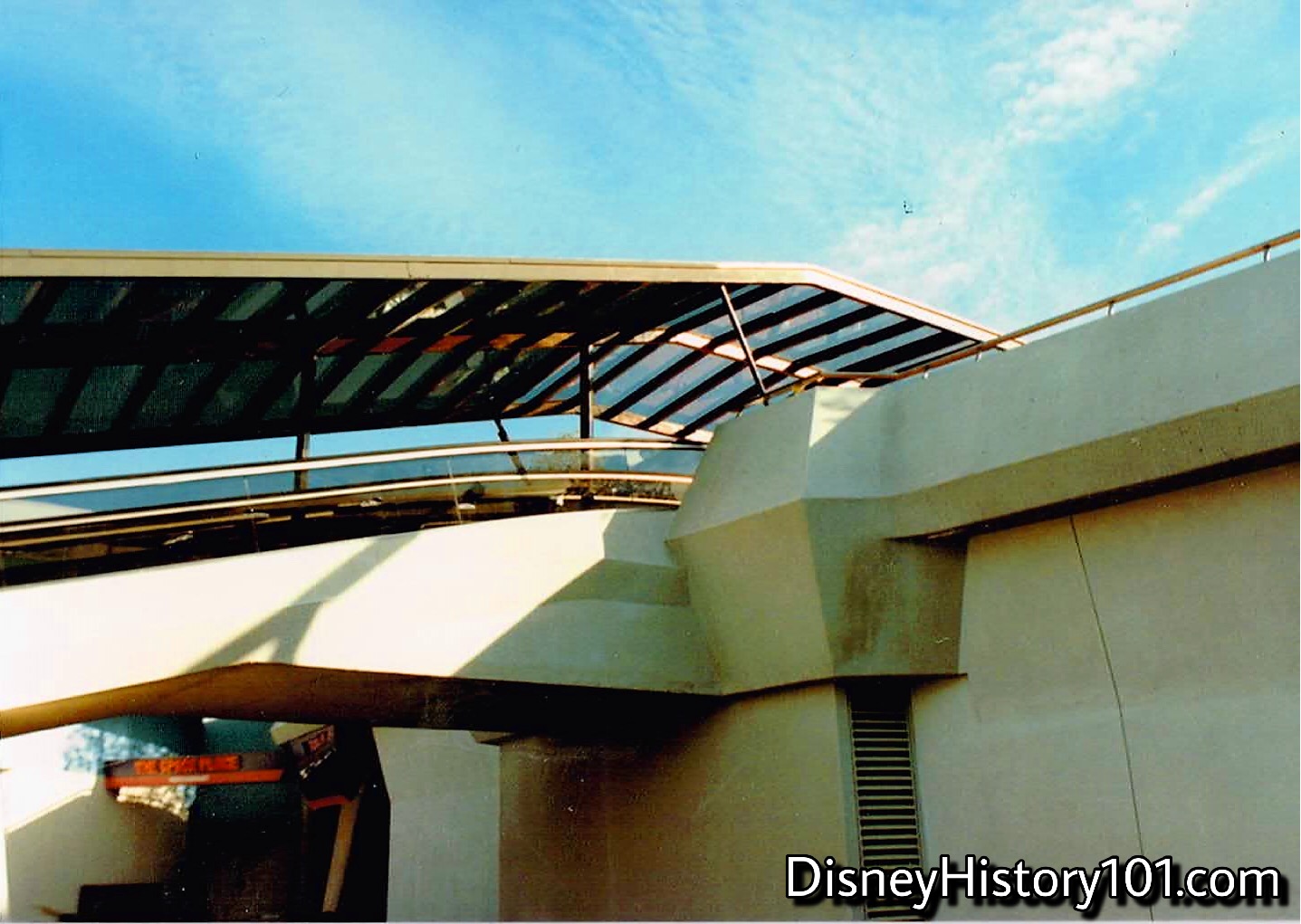
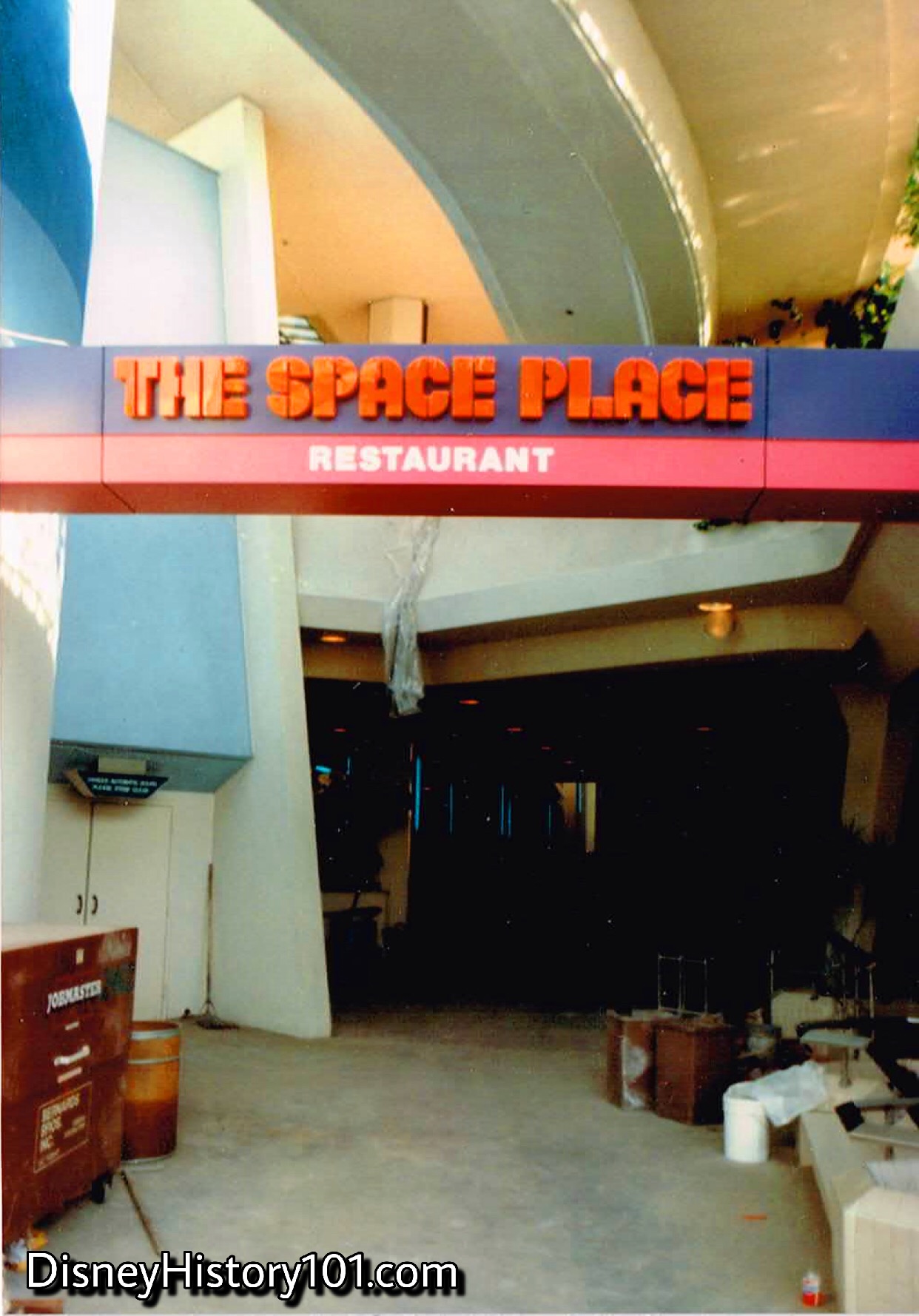
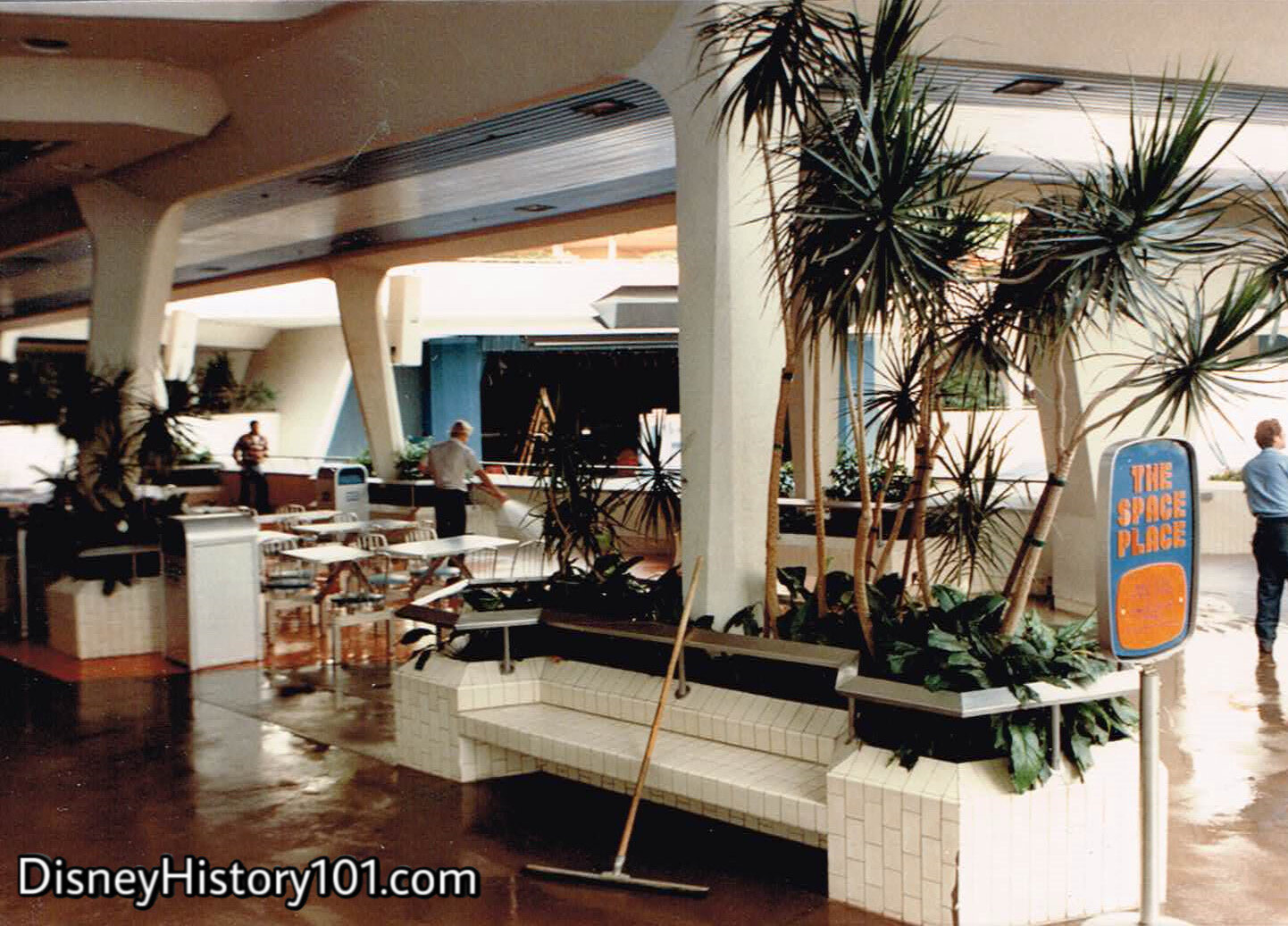
As the newly-laid Space Place floor is being hosed off, you’ll notice the adjacent Space Stage where big-name “out-of-this-world” bands would play!
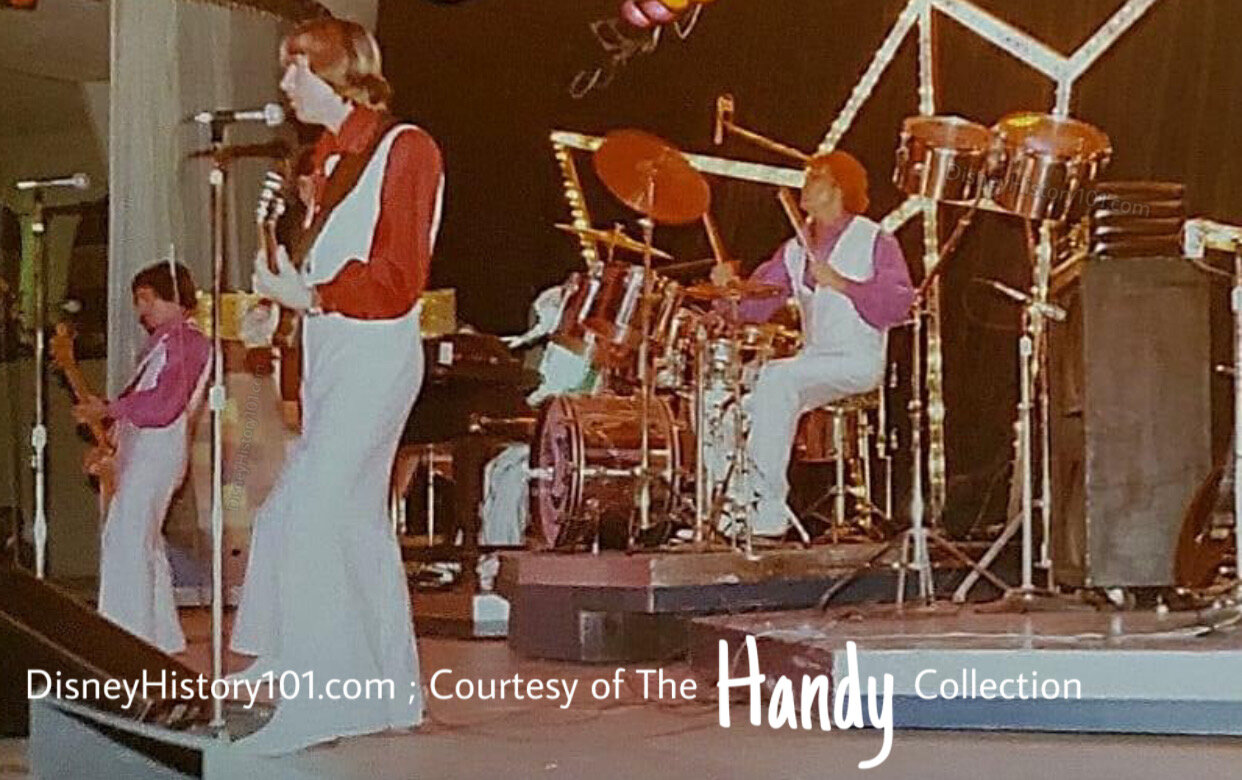
Core members Don Zirilli (keyboard) and Jim Shippey (drums), were only recently joined by Mark Ward (guitar and vocals), and Jim Armstrong (guitar and vocals). In 1975, the “Cupertino cover band” began its successful and memorable 15-year engagement as Disneyland’s “celebrity cover band”.
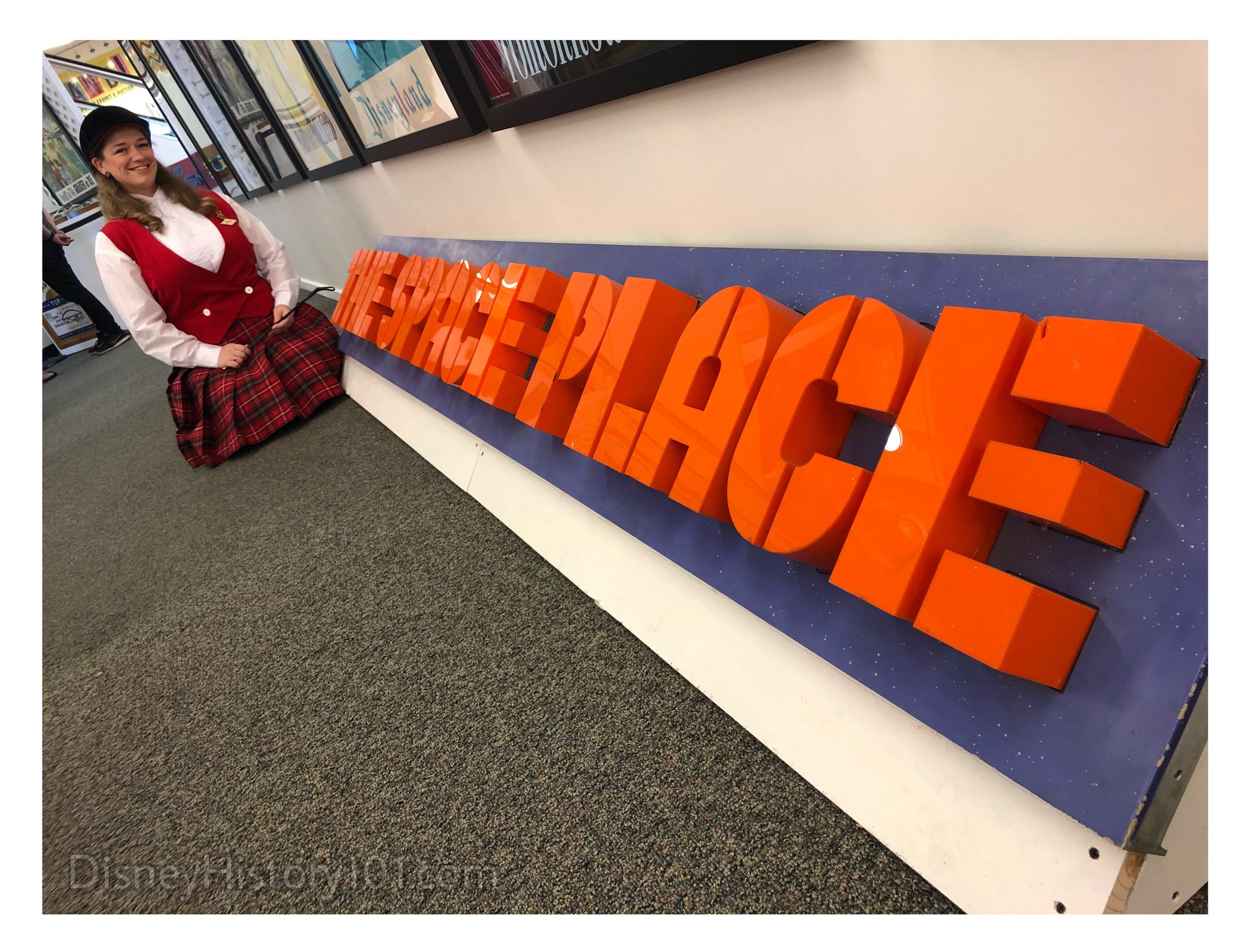
This is the likely the Space Place sign seen in a previous photograph, the one that first directs guests to the Tomorrowland dining destination! The fiberglass letters were once capable of illumination.

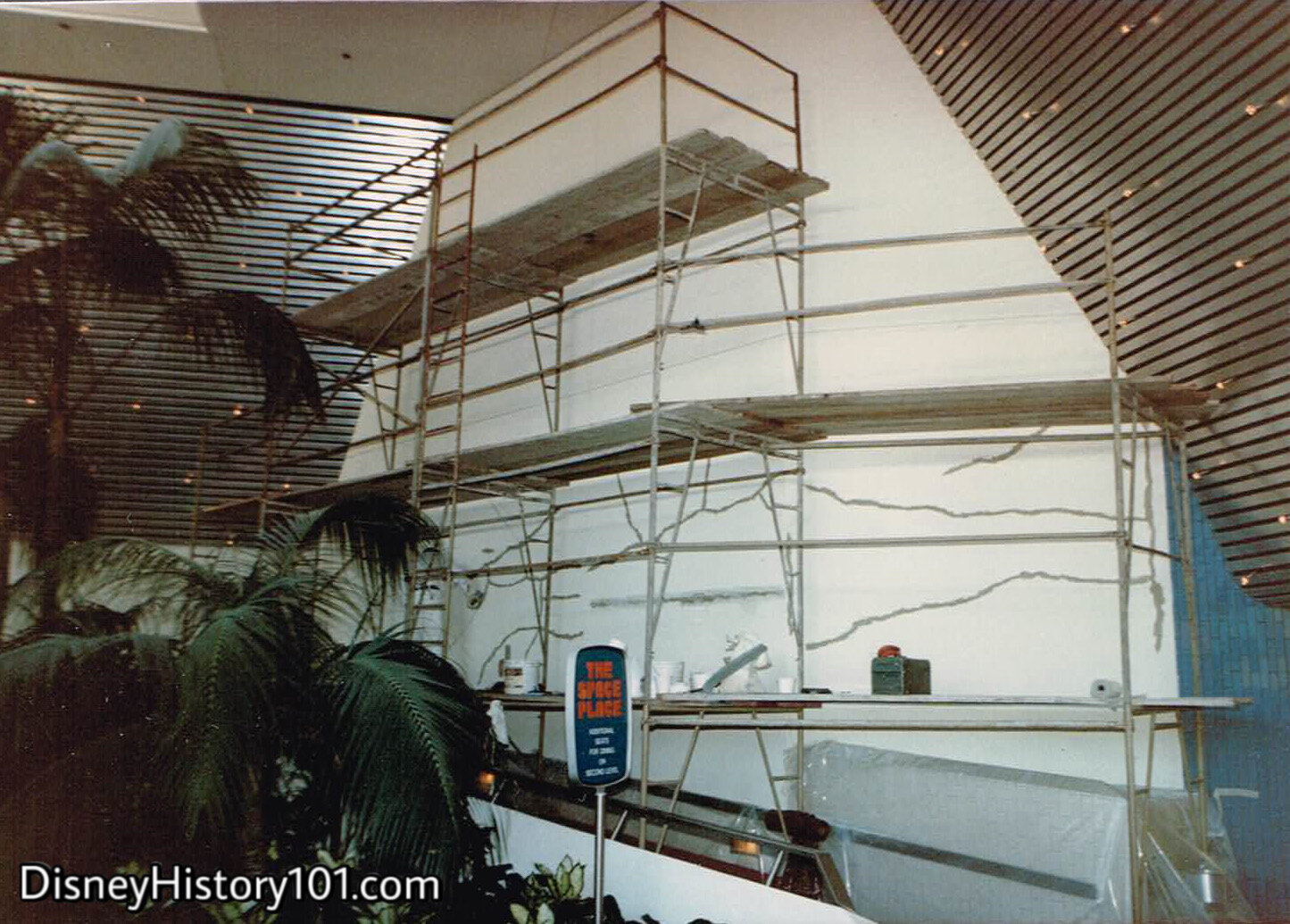

Adjacent to the Space Stage (where new tile ground is being laid), was the Space Place.
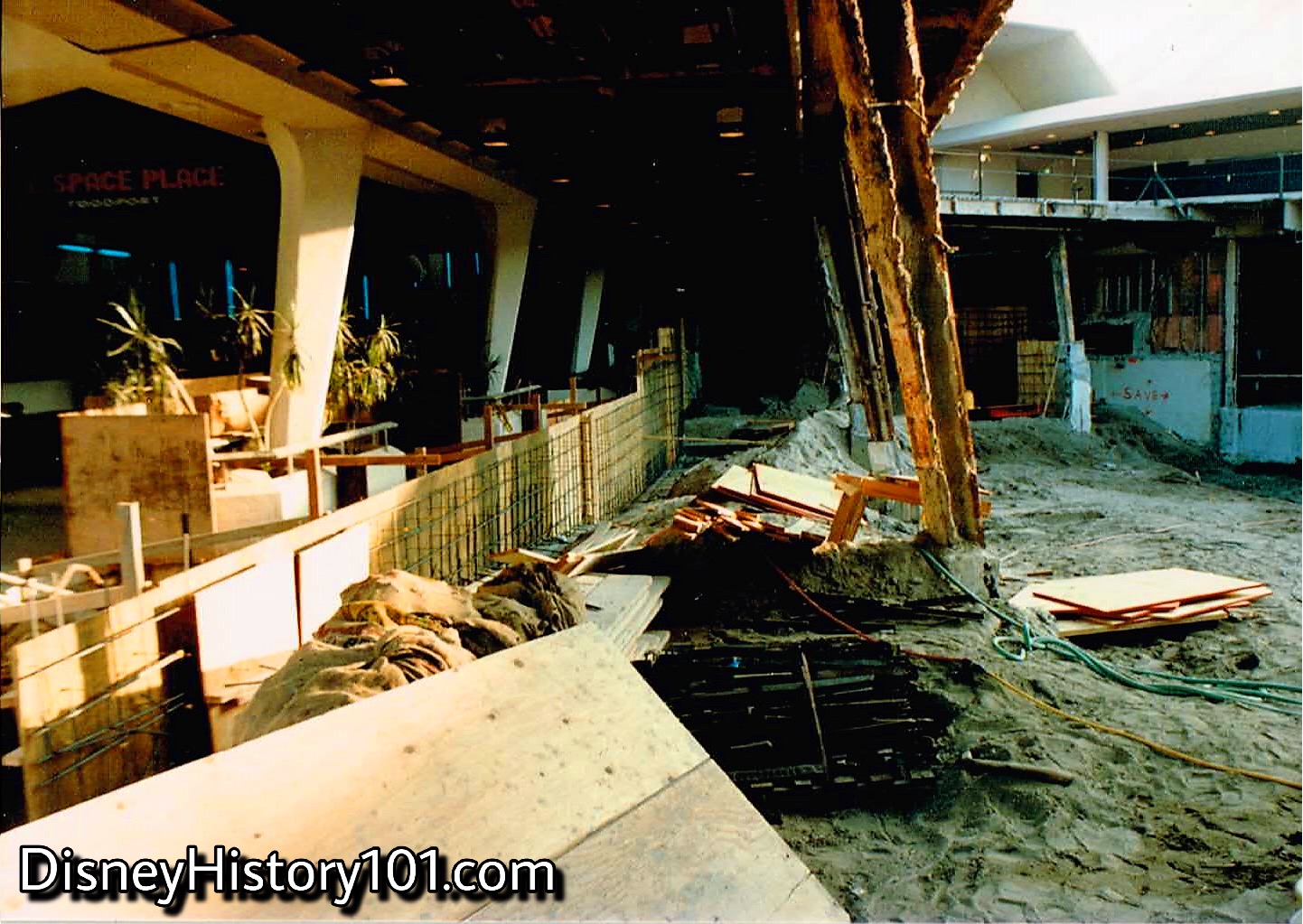
Just through the arches of the East Promenade (on the left), you notice the pathway leading to the Space Place!
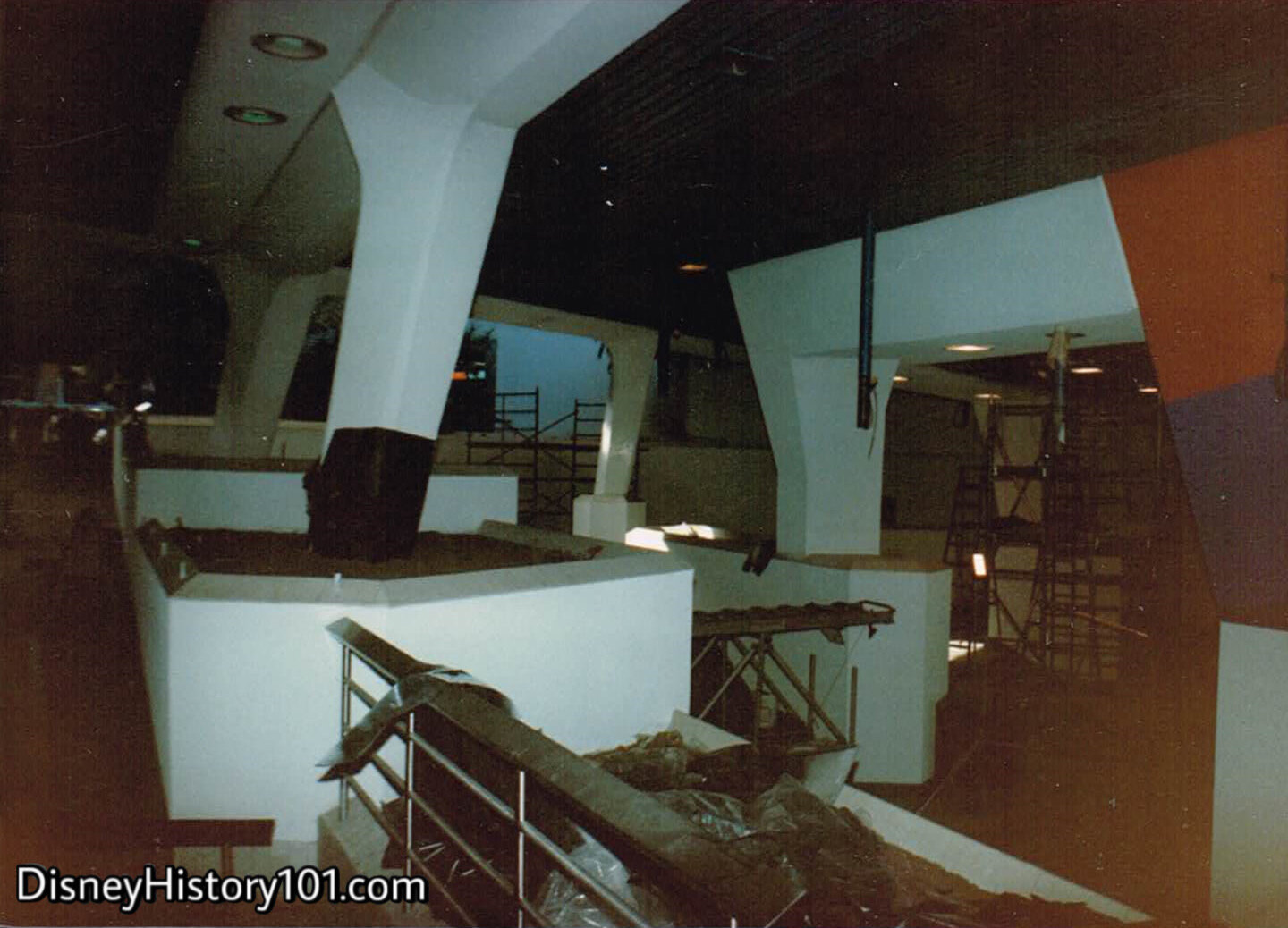
Space Place and Space Stage refurbishment included a new color scheme. The lower area (to the right) would later become the Pre Show Area for the Magic Eye Theater.
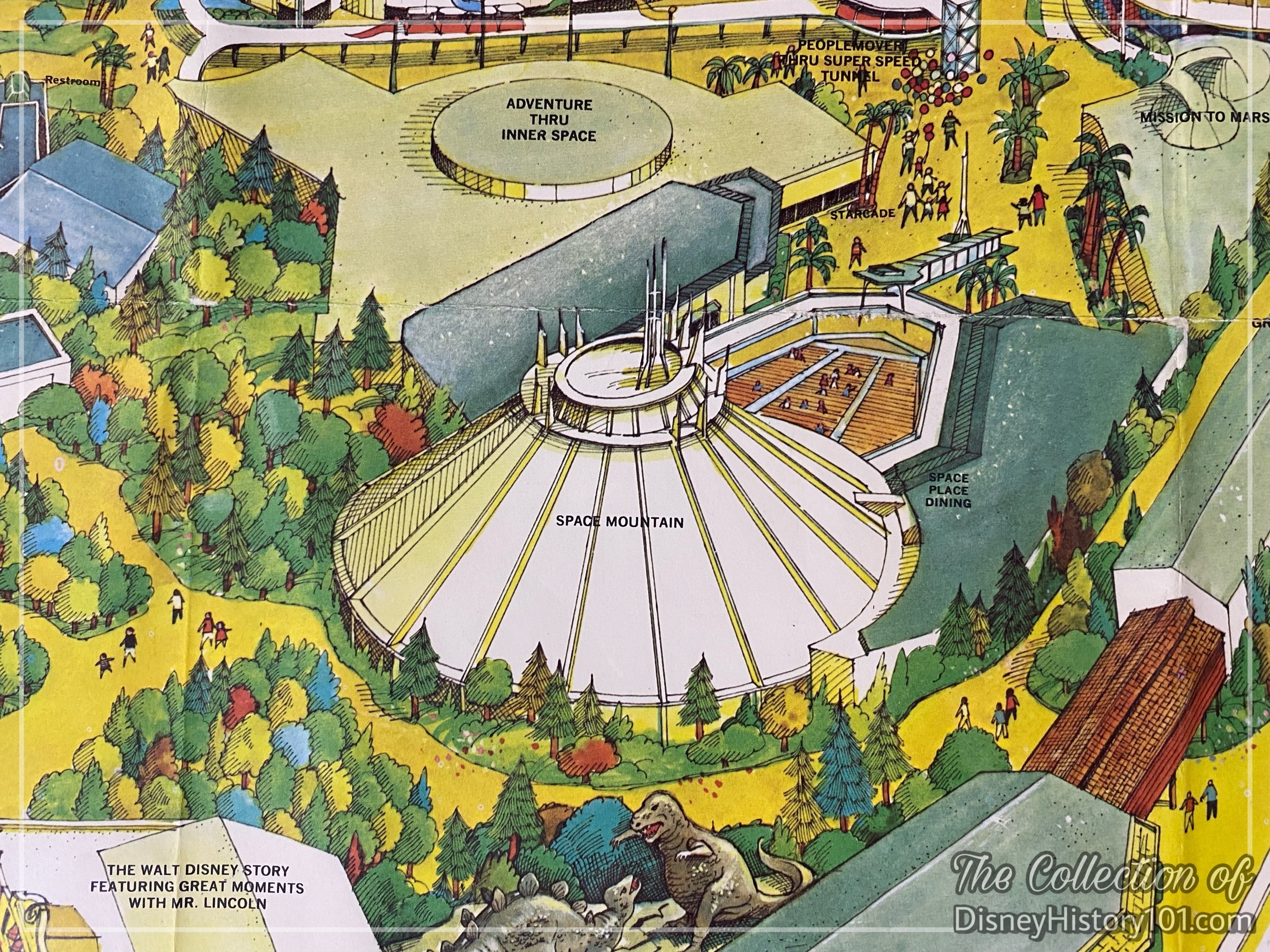

The Space Place upper dining terrace would receive a major overhaul around Space Mountain.
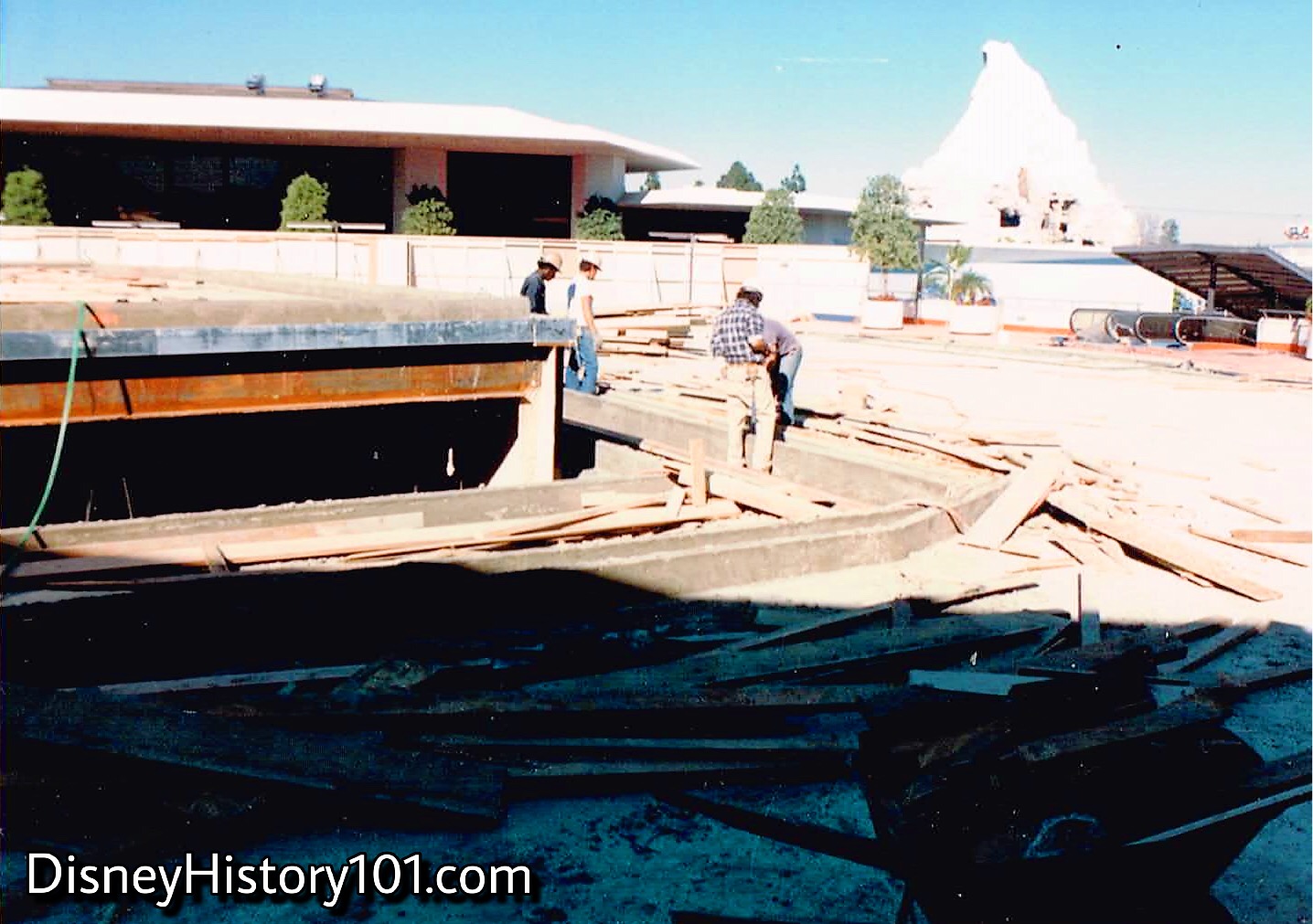
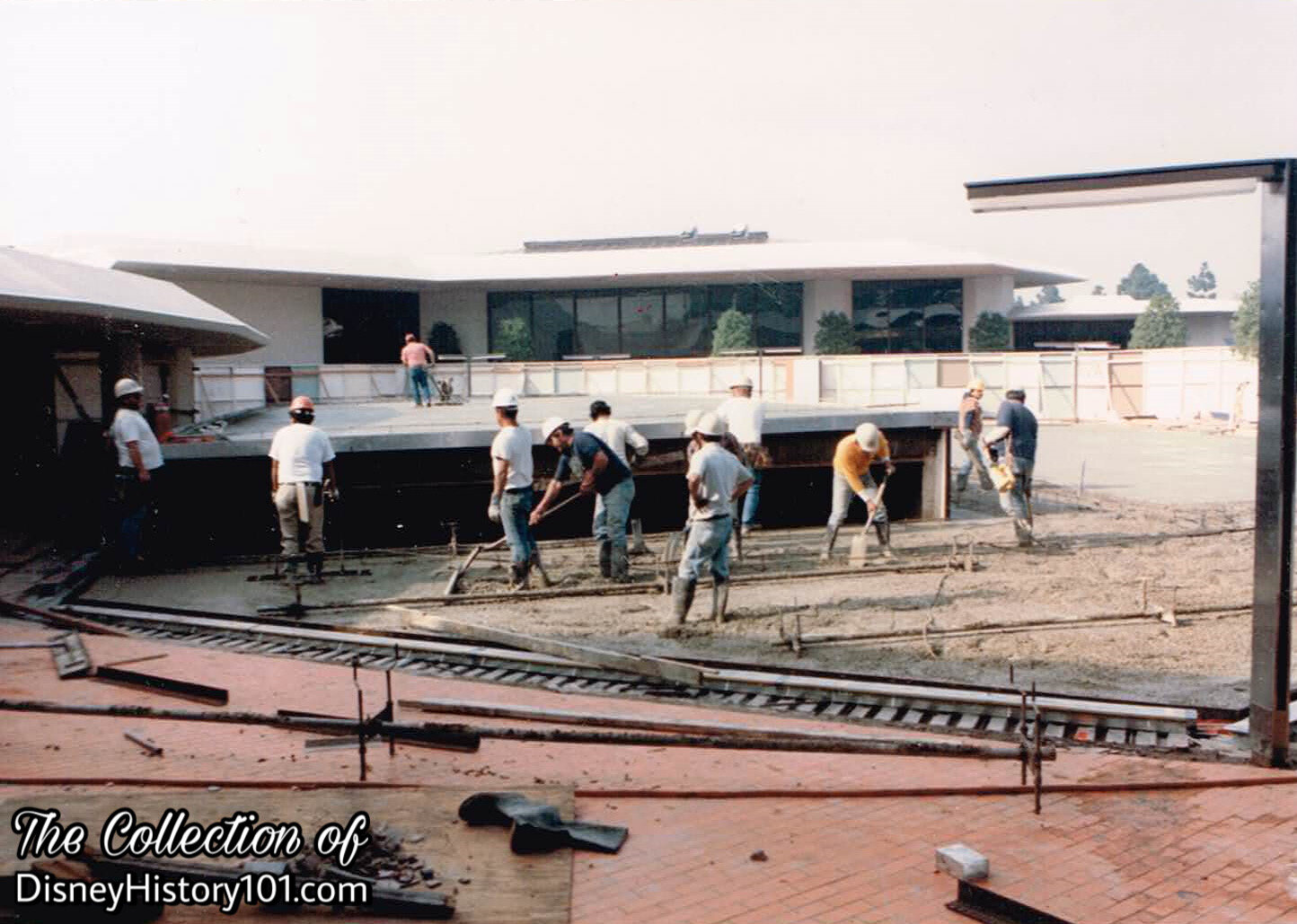
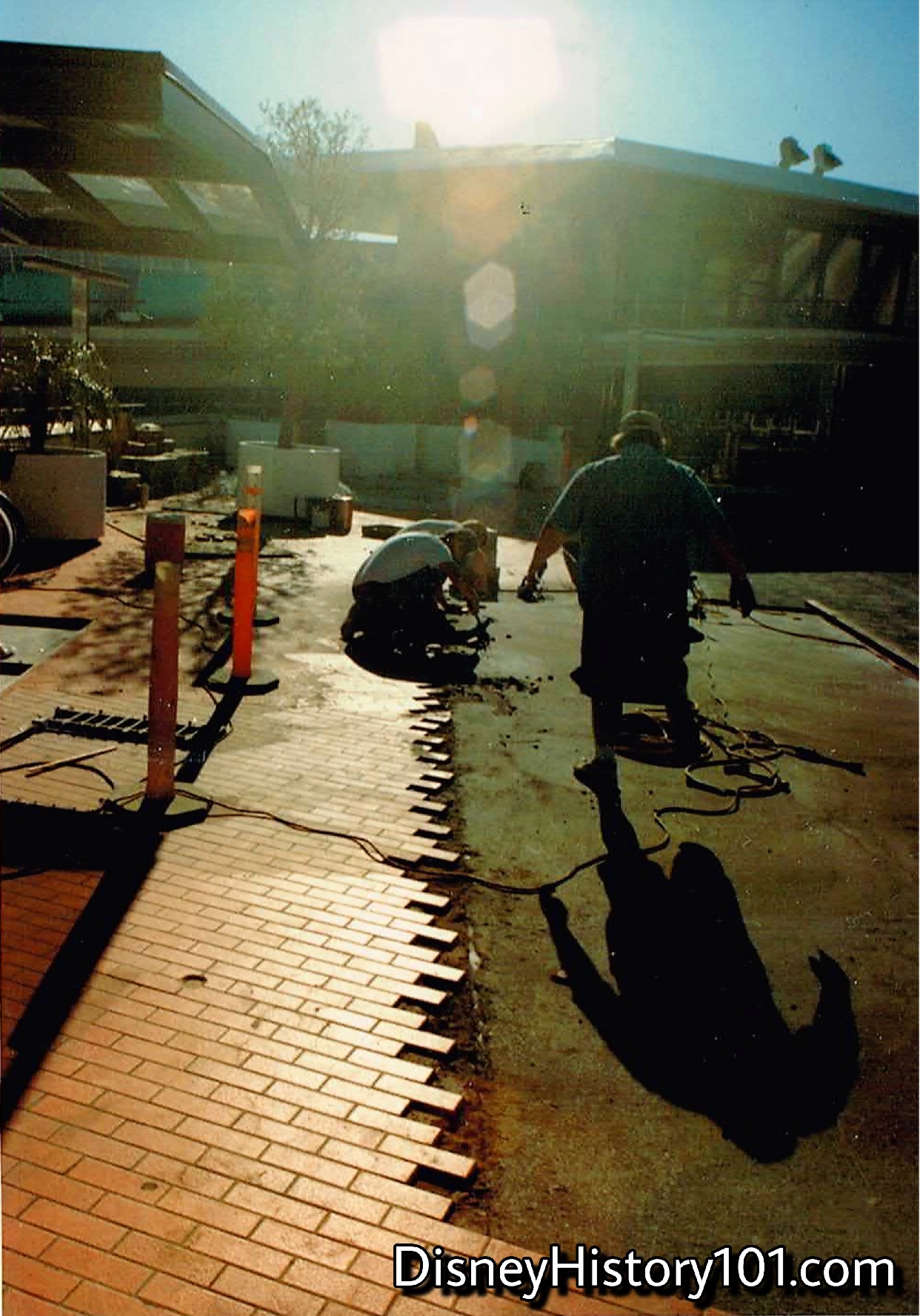
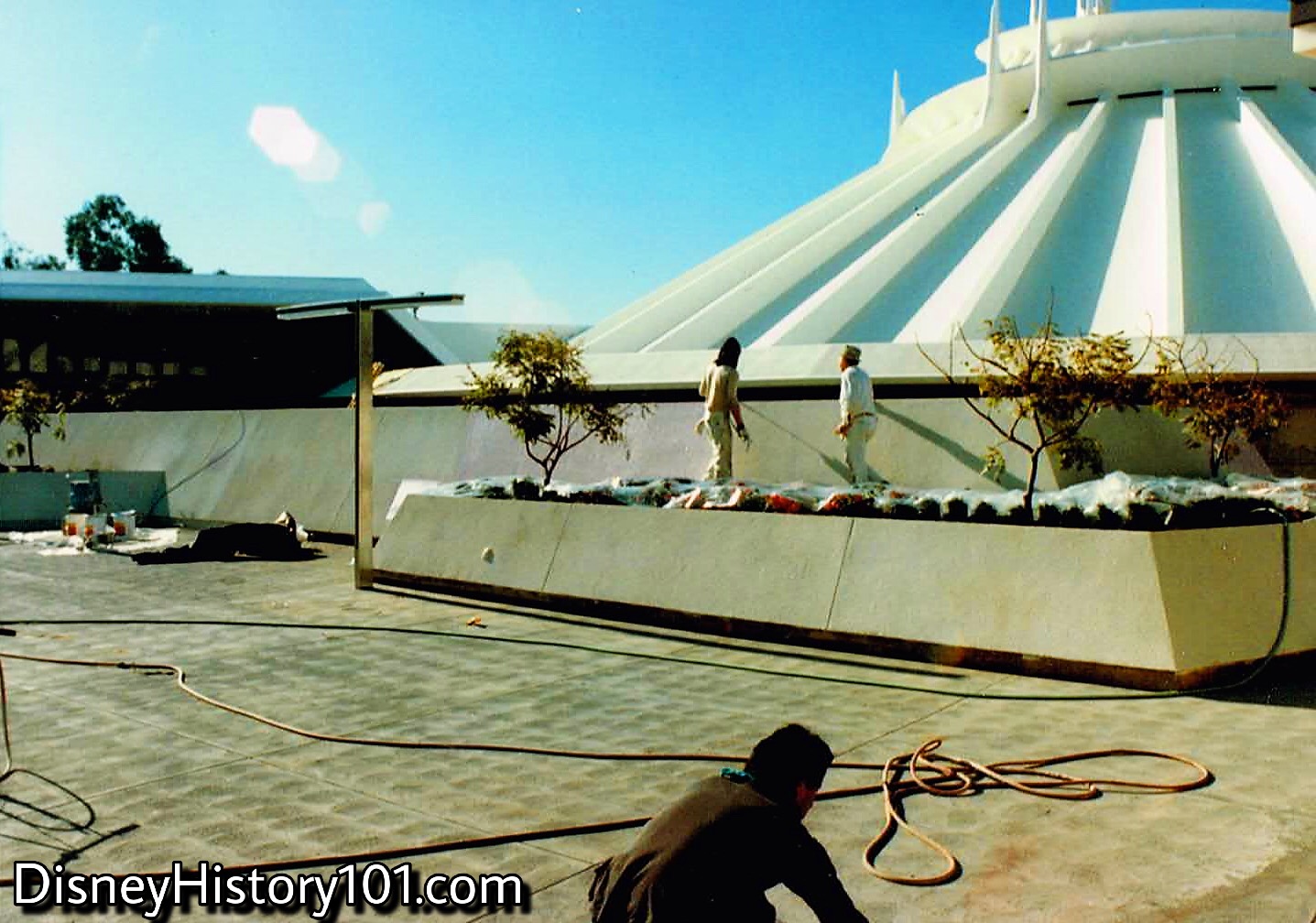
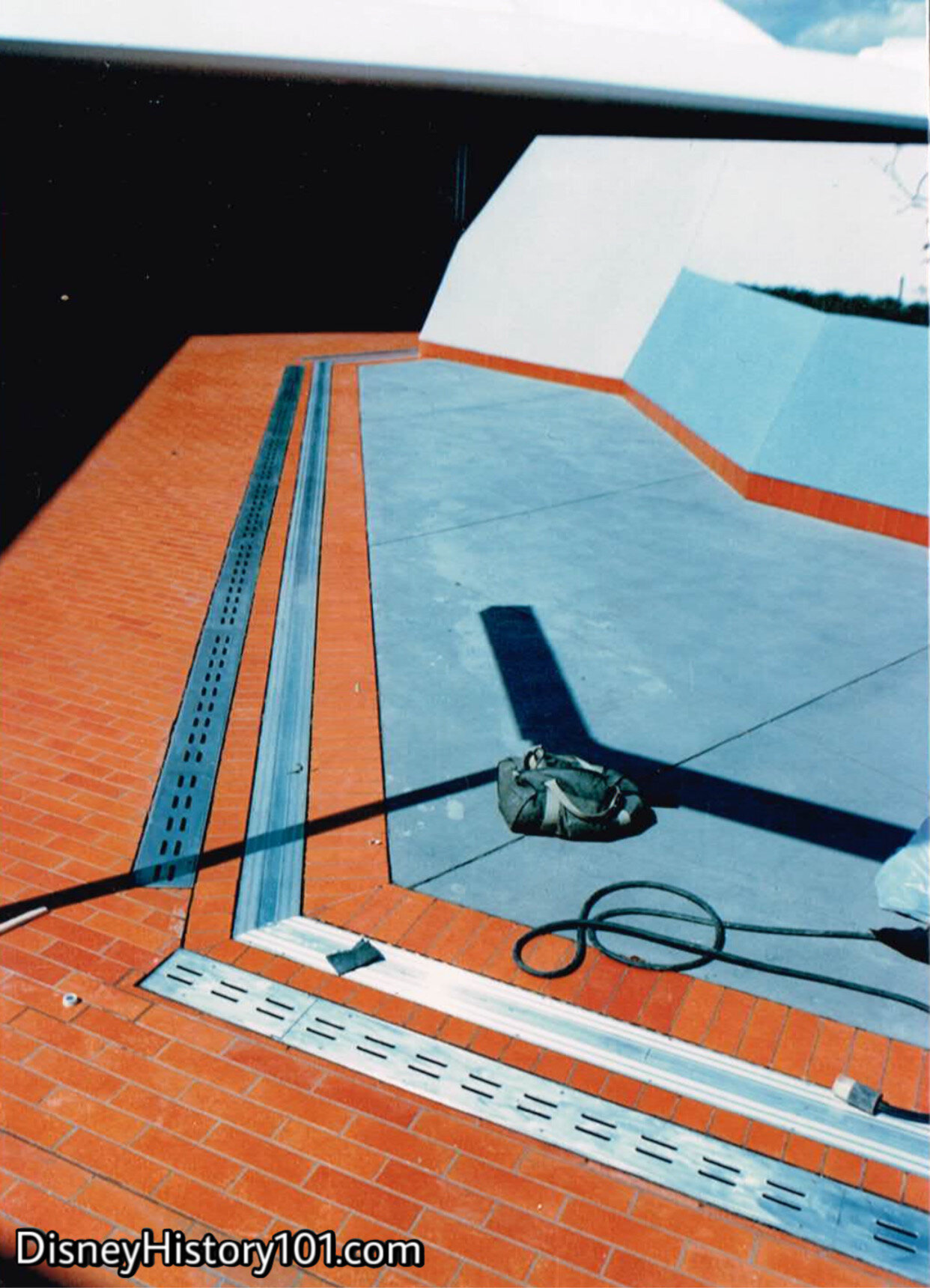
Space Place upper dining terrace refurbishment (new InterPace tile floor, and metallic drain grating). The color was known as “John Hench Orange”.

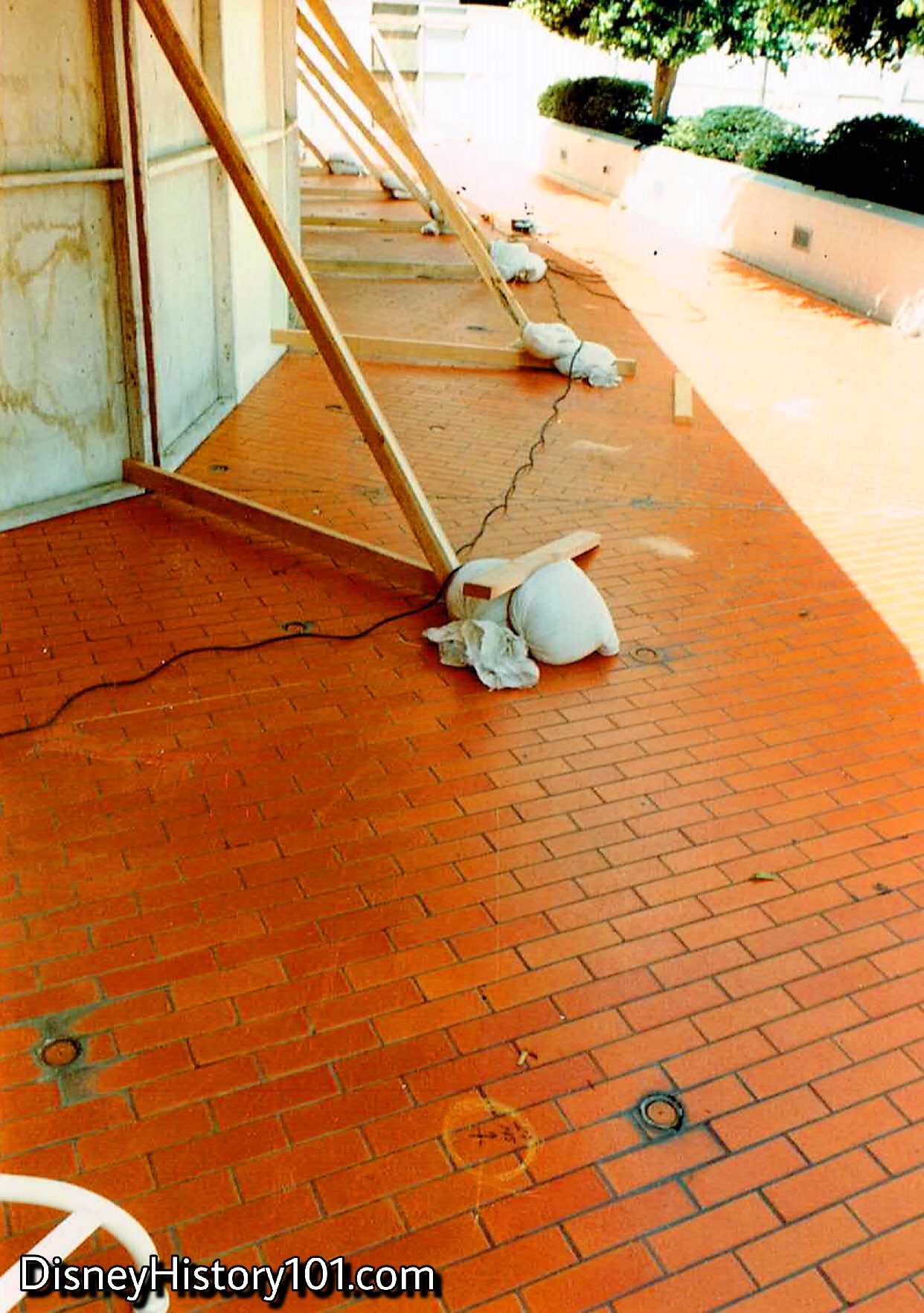
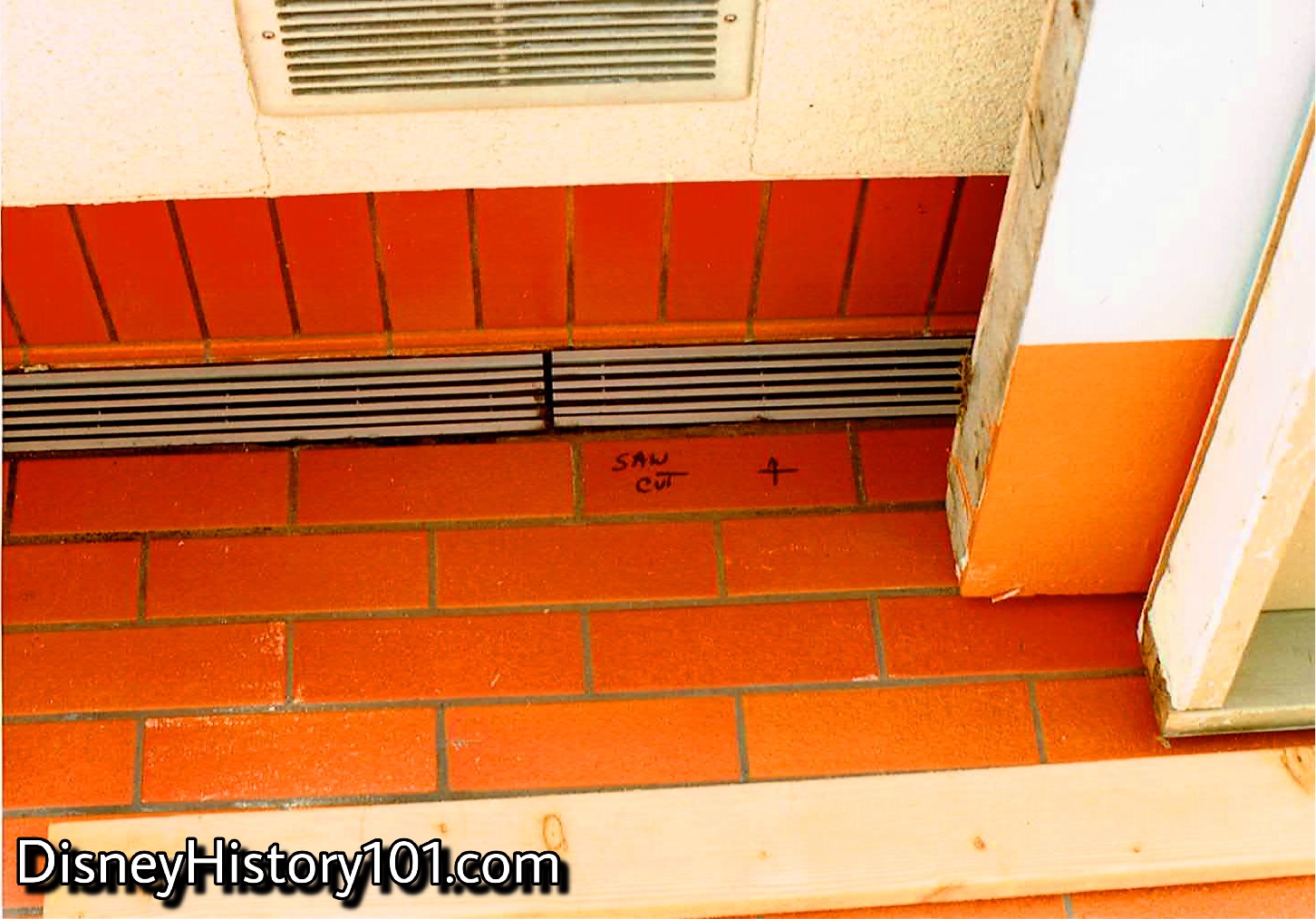
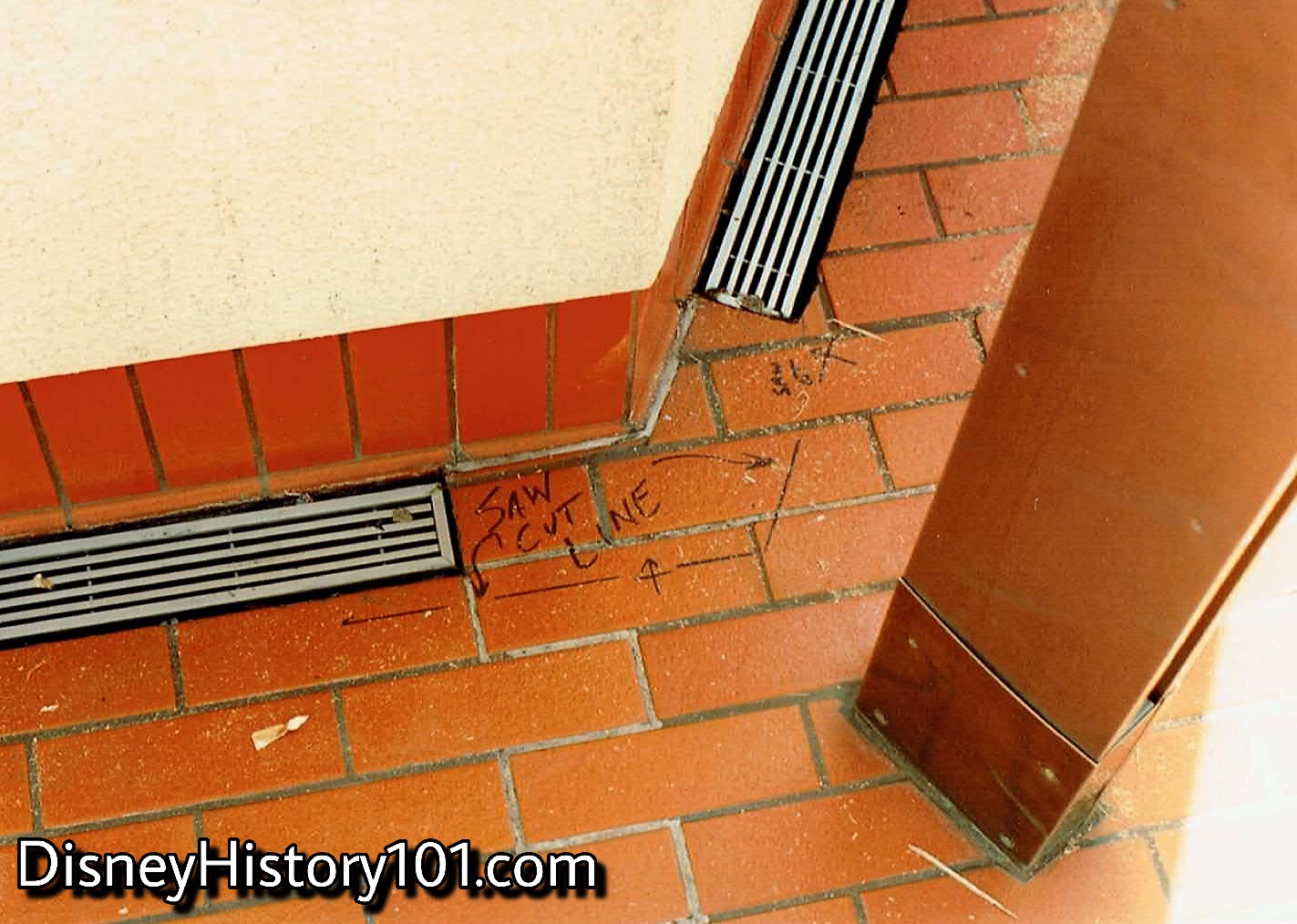
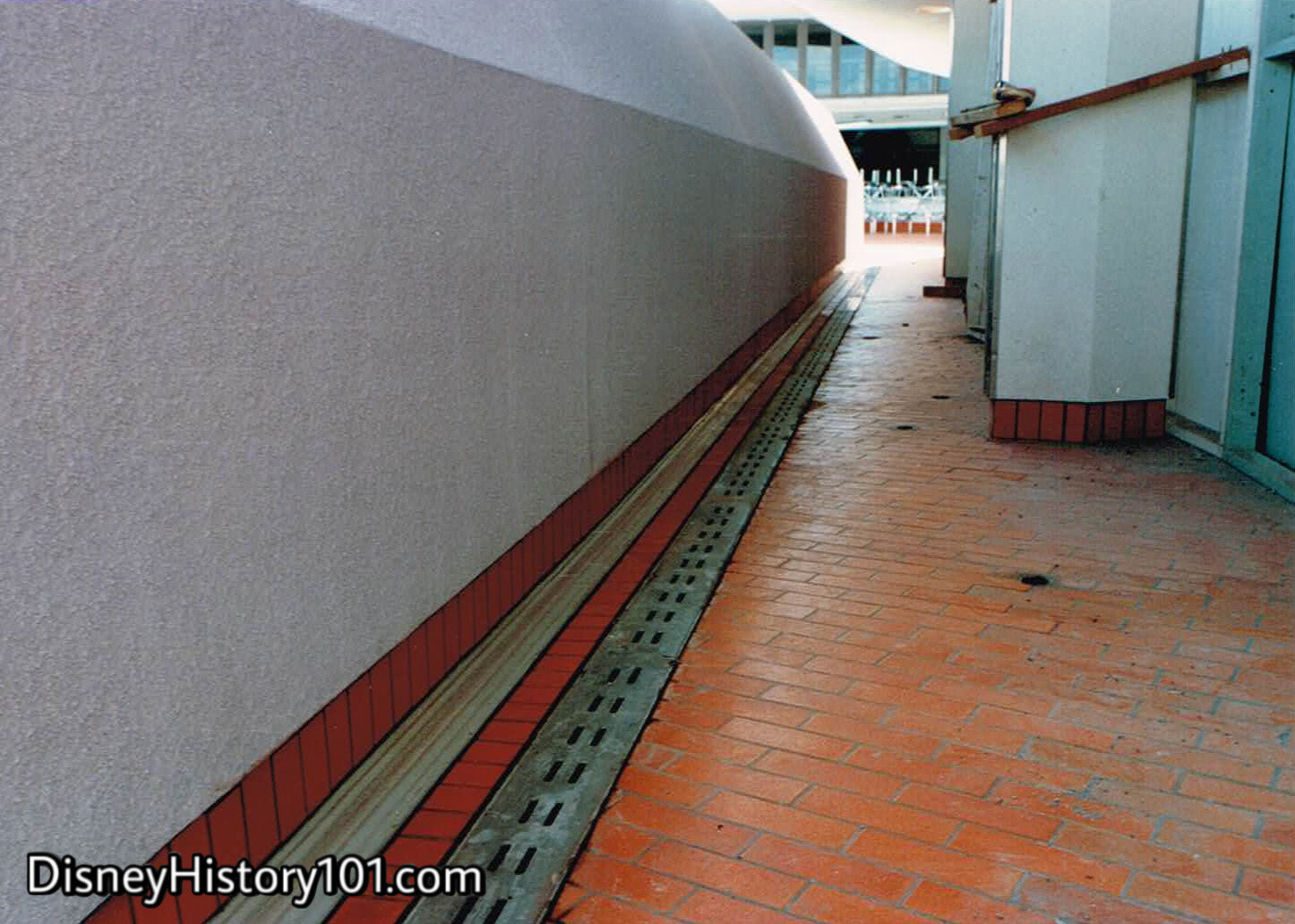
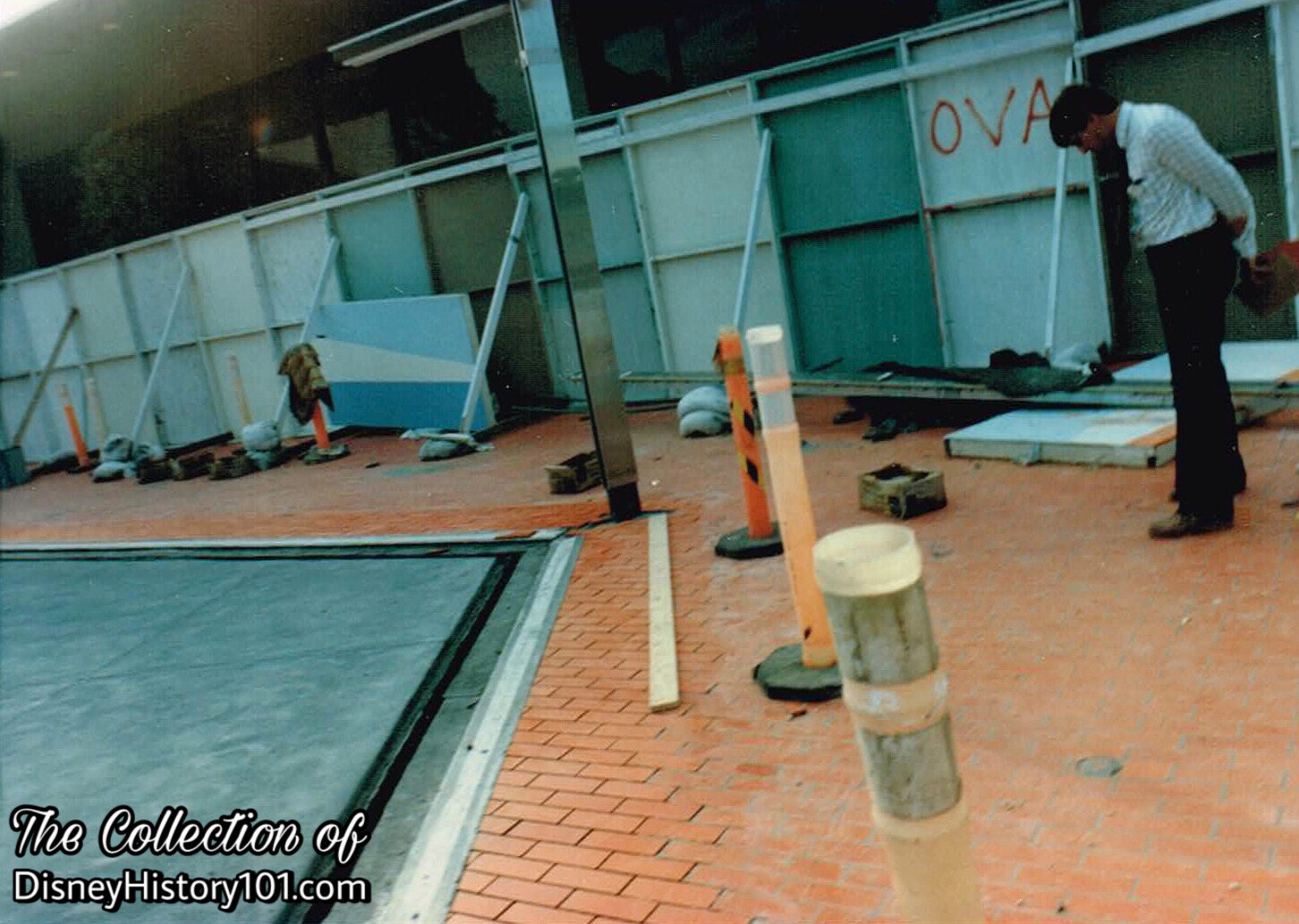
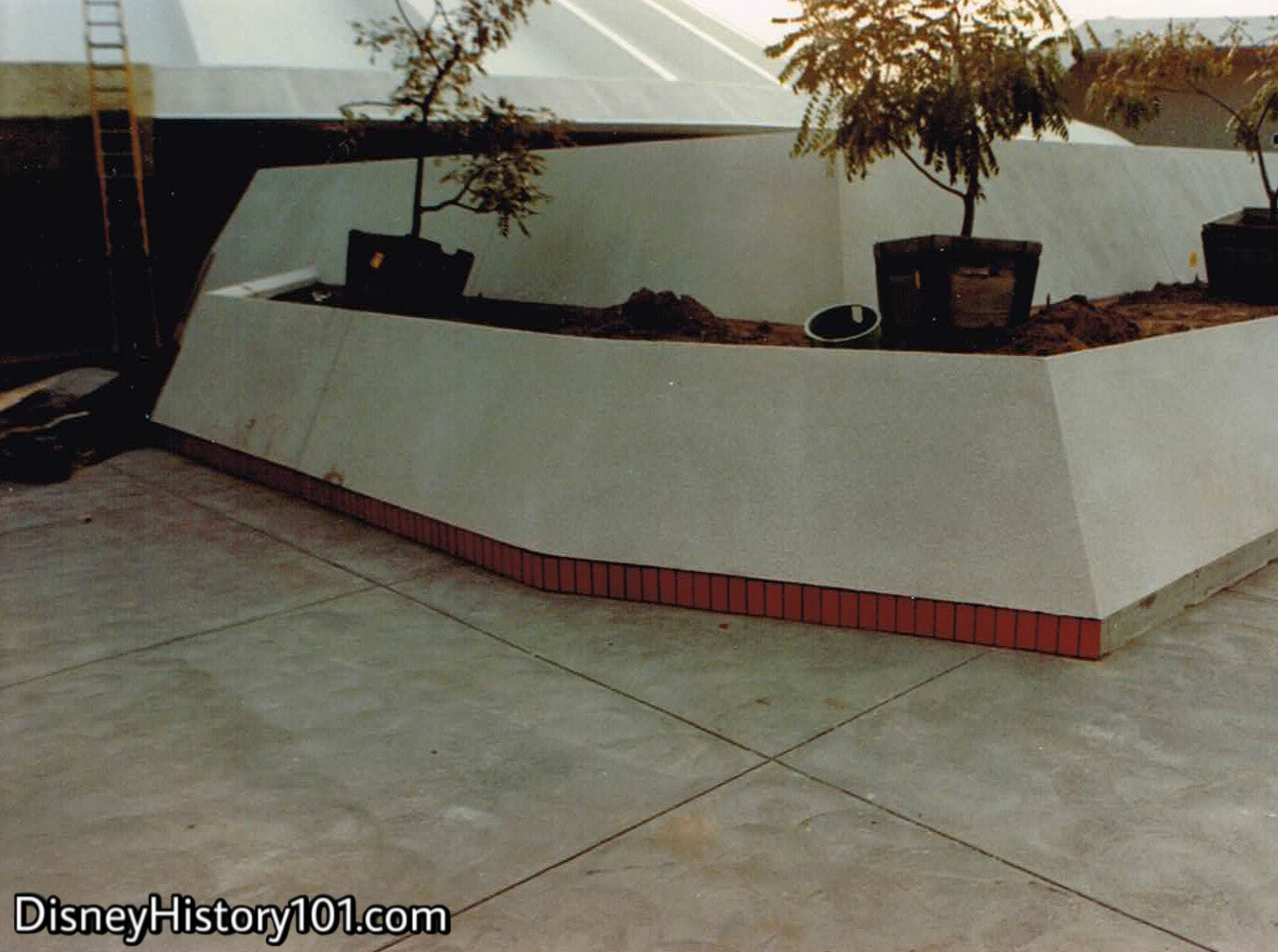
New planters on the upper dining terrace would hold shade trees, to shield diners from the sun’s rays.
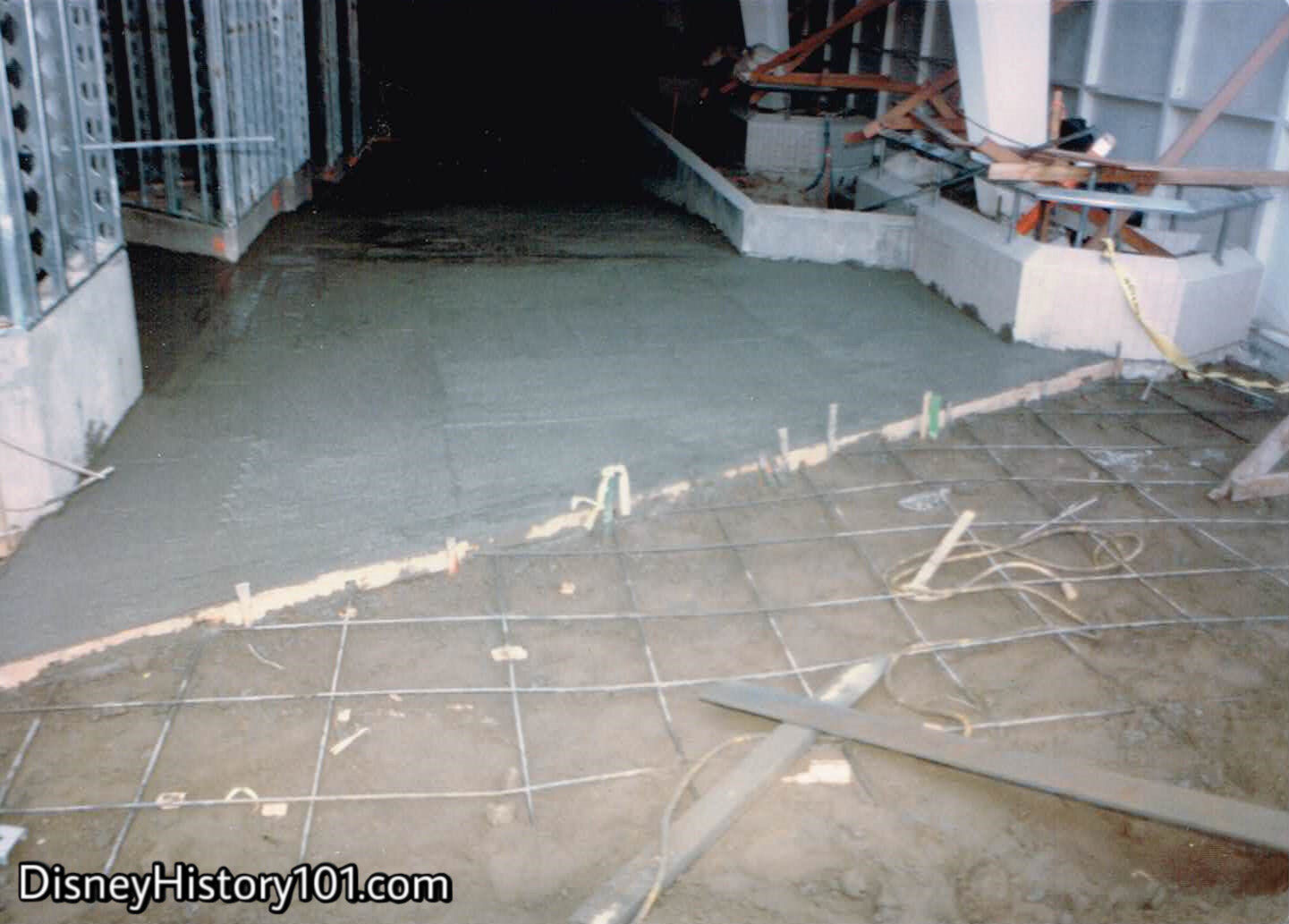
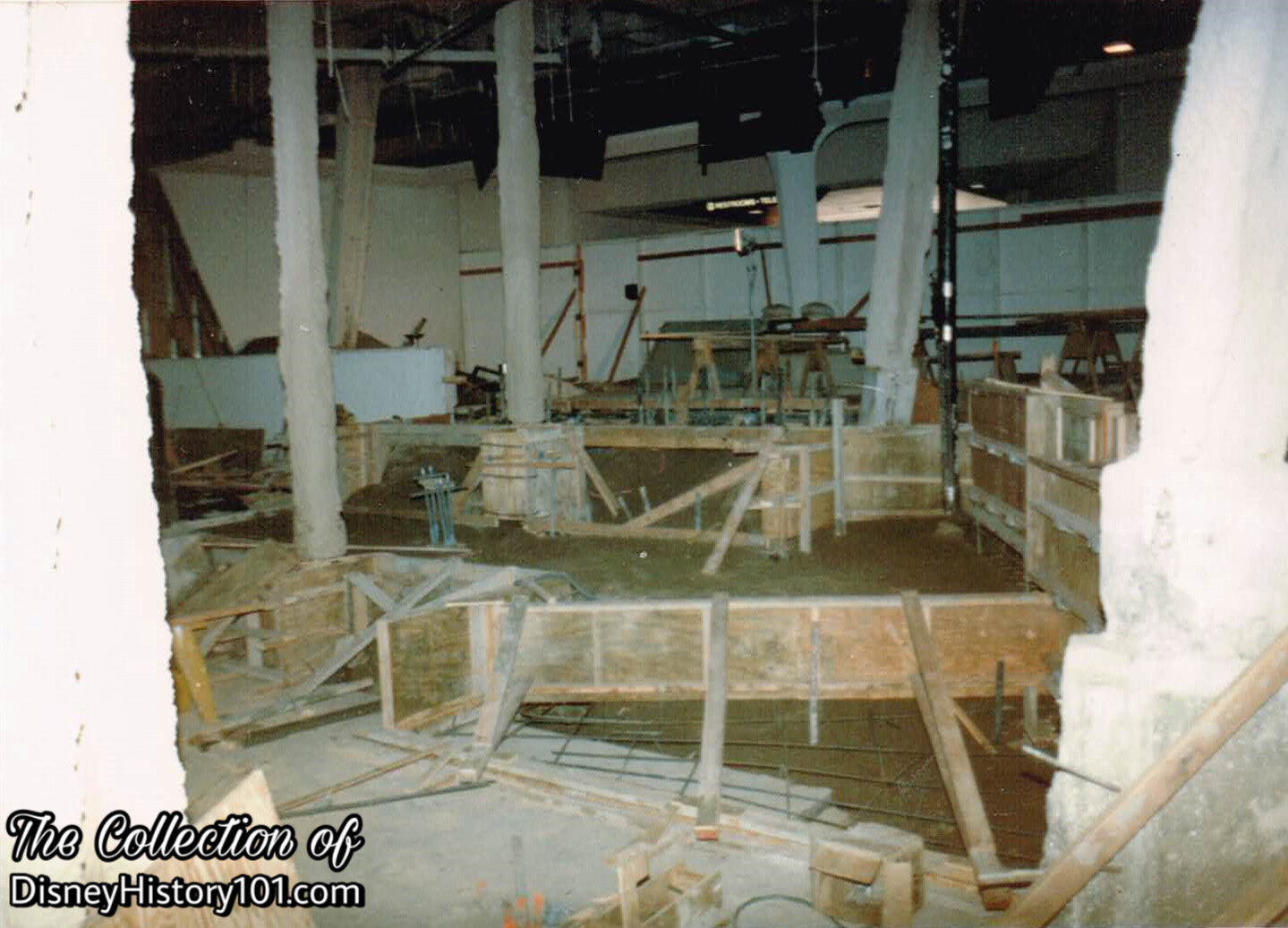
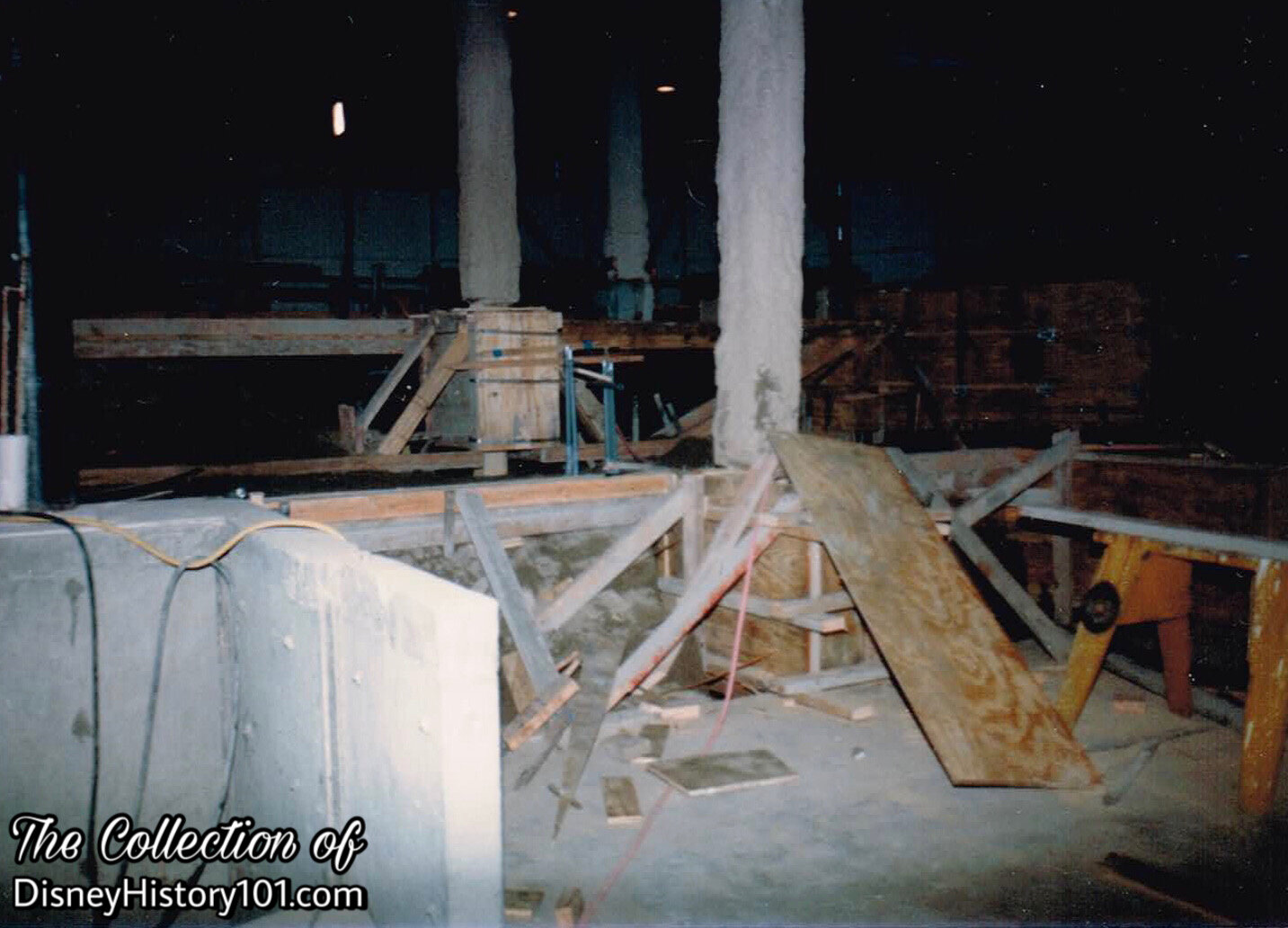
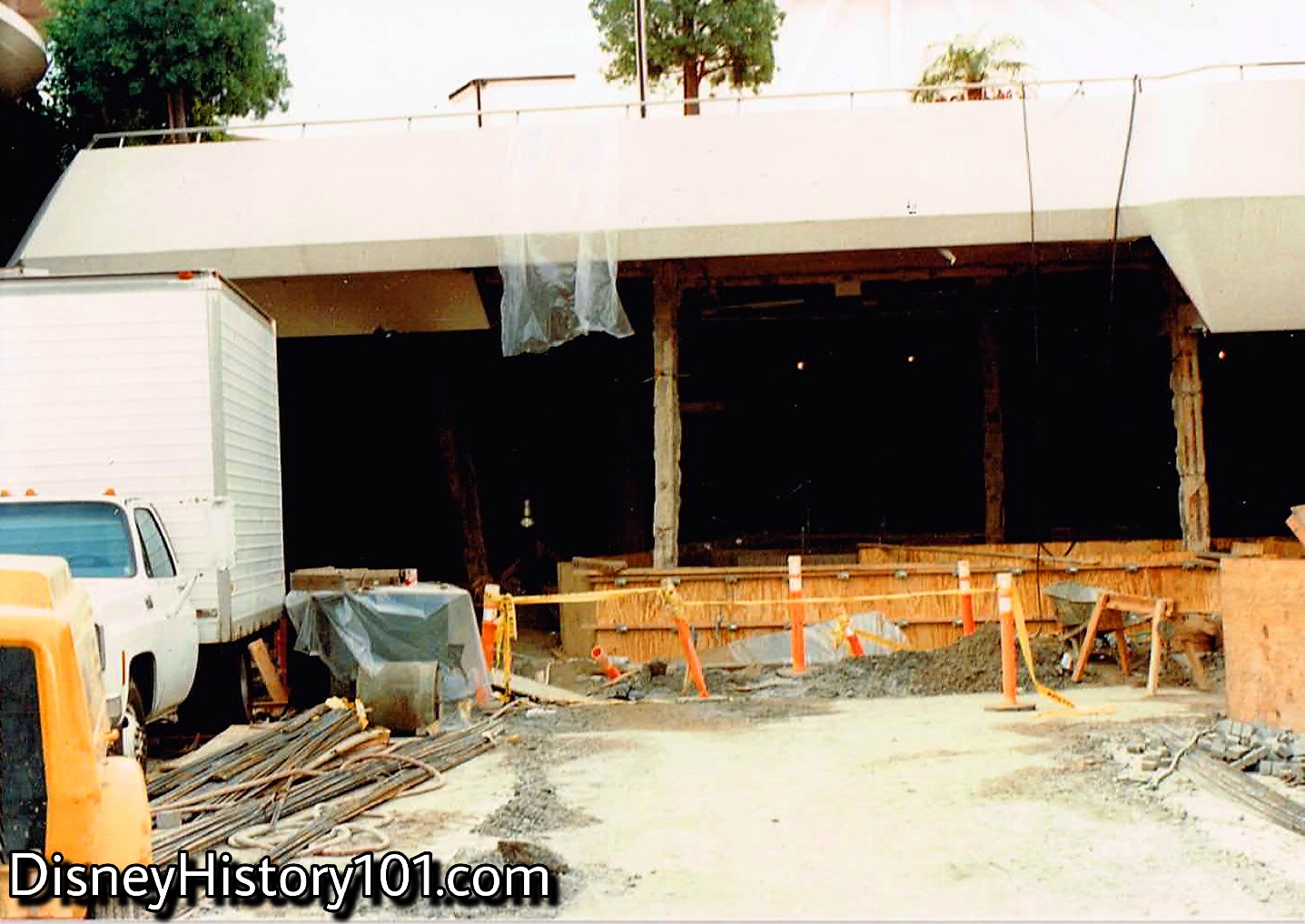
There was once, a more direct route to the upper level (currently leading to the Space Mountain entrance).
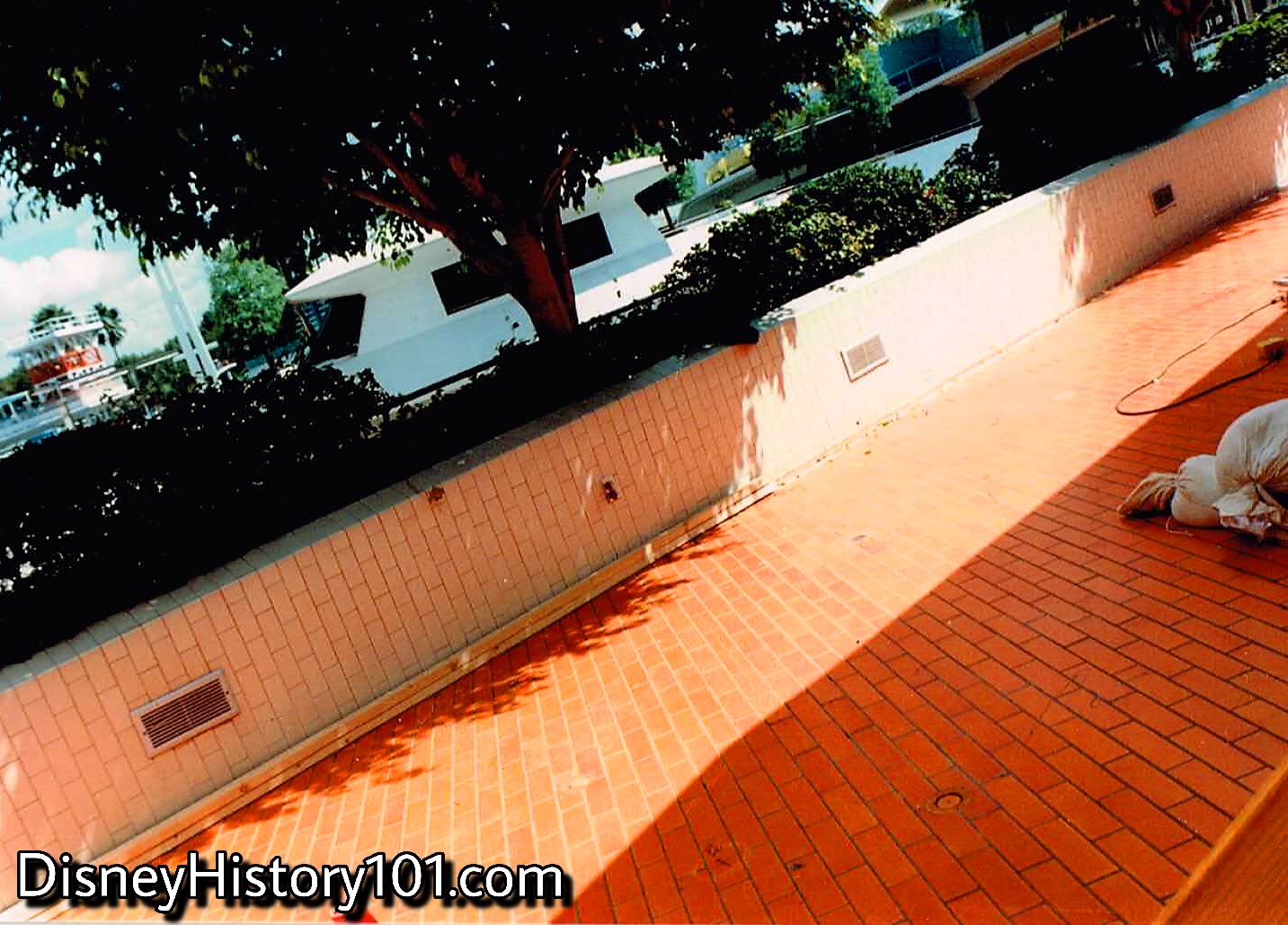
The second level of the Space Place and the Concourse also offered a view of the Tomorrowland Terrace.
TOMORROWLAND STAGE (SPACE STAGE & MAGIC EYE THEATER)

It is true that Disneyland itself has been reckoned a large stage, where a grand show takes place! Within that grand show are many smaller “stages” - attractions, exhibits, restaurants, shows and entertainment! Tomorrowland too, has also been referred to as one of Disneyland’s many stages. All these facts considered, through the decades, Tomorrowland has had more stages than the Carousel of Progress. Some of these stages were very small for spotlighting small acts (like the General Dynamics Stage used by the Yachtsmen), while some of these stages (like the Space Stage, or Tomorrowland Bandstand) had the ability to accommodate large casts of stage stars and personalities (like the New Mouseketeers or the All-American College Singers) and their “back-up bands”! Please step this way as we explore the progression of the Tomorrowland Stage!
“The Tomorrowland Stage Lands”
After both the Flying Saucers and Tomorrowland Art Corner disappeared from a large terrestrial area of Tomorrowland, stars would descend upon the former Disneyland Space Station location during the massive Tomorrowland refurbishment due to be unveiled during the summer of 1967! Revealed were two different stages that would showcase live entertainment.
Tomorrowland Terrace (would rise both out of the ground, and in popularity) for its “happening bands” and “now sounds” of today! However, so many talented acts could not be contained on just one stage. So a second stage - the Tomorrowland Stage (also called the Tomorrowland Bandstand) - would bring more “out of this world” (often in two-week engagements), to this corner of Disneyland! According to “INFORMATION ON DISNEYLAND'S NEW TOMORROWLAND - A WORLD ON THE MOVE” (©️ 1967 Wed Enterprises, Inc): “Special events - musical attractions and dances -are presented at the Tomorrowland Bandstand, located on the concourse between Flight to the Moon and The Character Shop.”

This new stage and 1,500 maximum guest capacity theatre was installed on the concourse between Flight to the Moon and The Character Shop, intended for special events like musical attractions and dances. The chairs were set up by DISNEYLAND MAINTENANCE SERVICES DEPARTMENT. Now, for some reason, the Tomorrowland Stage was unavailable for rehearsals when it first opened, during the spring and summer of 1967. Owning to this, the Grad Nite Humdingers (which were planned to be held in the new venue) were temporarily performed in other areas of Disneyland, like the Fantasyland Theater. But soon, the Tomorrowland Stage (with its boldly-colored rainbow rising in air) was one of 10 Disneyland Stages utilized for showcasing “big name” talent - from recording favorites to personalities from motion picture and television, during exciting summer nights!
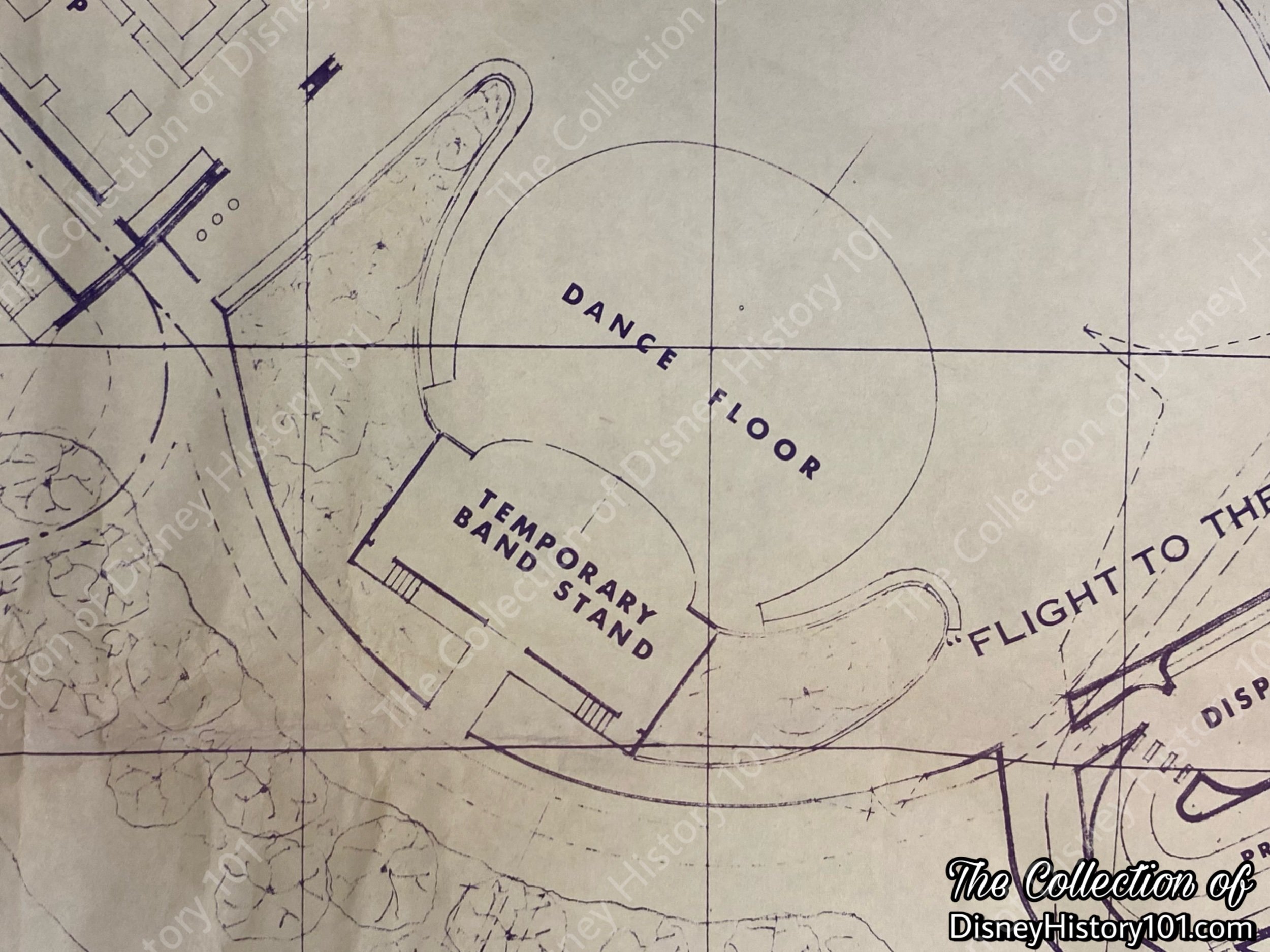
In addition, the Tomorrowland Stage was the setting for employees-only shows (like the “Lead Foreman Summer ‘72 Kickoff Dinner”, at 5:30 p.m., May 15th, 1972) featuring fellow Disneyland Cast Members parodying and satirizing “Disneylander” life, while fellow Cast Members dined on “super steaks.” Here (after hours of operation), the Disneyland Drama Workshop club would perform skits for Disneyland employees (and their family members) from theTomorrowland Stage. Tom Pletts recalls : “Our Drama Workshop performed [Foreman’s Banquet Show - a one-time production] there for the company’s summer banquet. Like Spring Tonics, we did some funny skits. I played a Security Officer, and at one point Bonnie went past me on a unicycle, and pushed a cream pie in my face. Anything for a laugh! Gee, we sure had it tough, huh?”
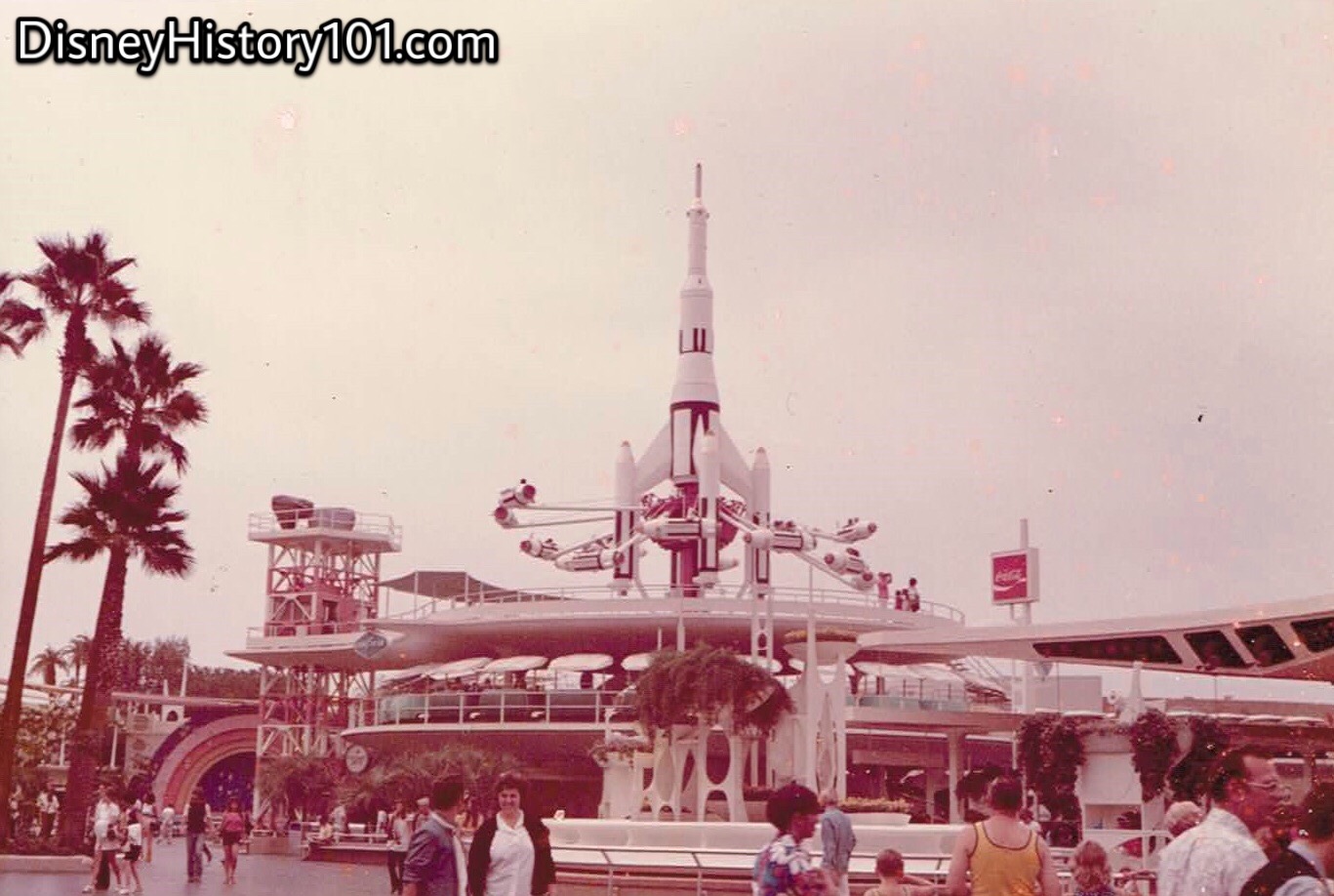
Not far from Tomorrowland Terrace, you’ll notice the Tomorrowland “Rainbow” Stage (to the left). The bold colors of its rainbow stood out, while not clashing with the well-established primary color schemes of other Tomorrowland attractions as the PeopleMover trains and Autopia Mark VIIs. Please step this way, as we take a closer look!
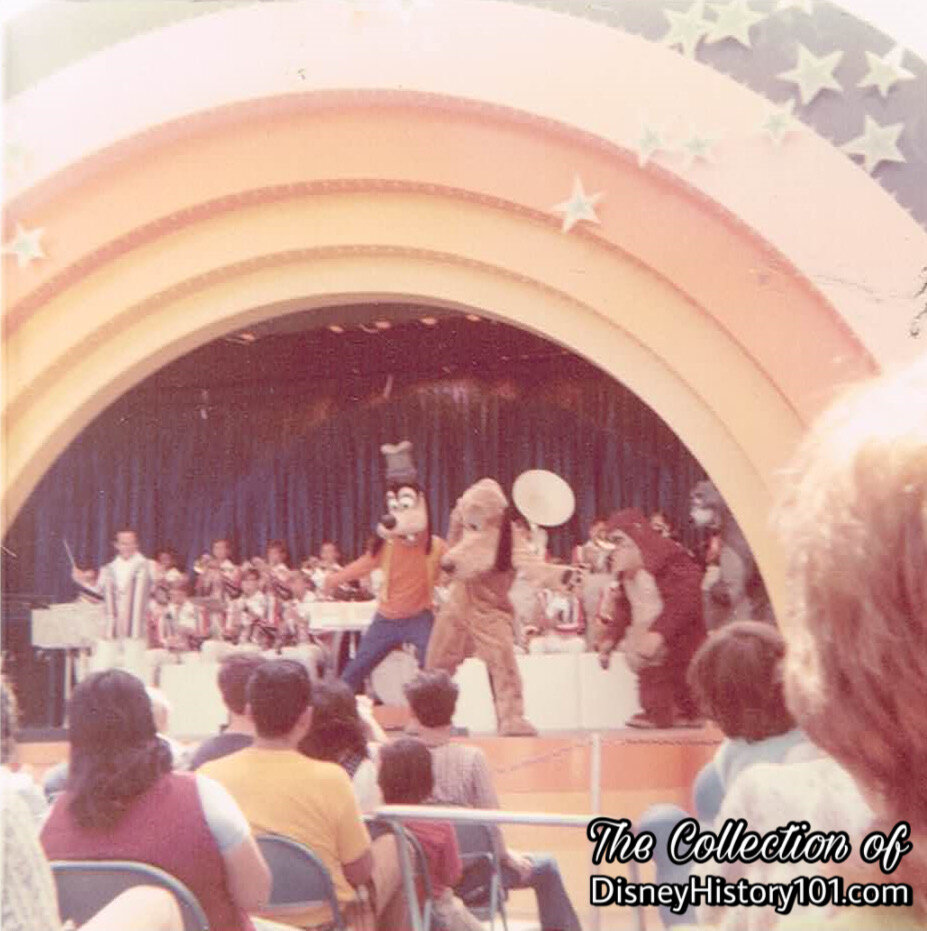
During daytimes, the Disneyland Characters generally entertained guests of all ages, with support from the Disneyland Band, the Pearly Band, or the All-American College Band (pictured)!
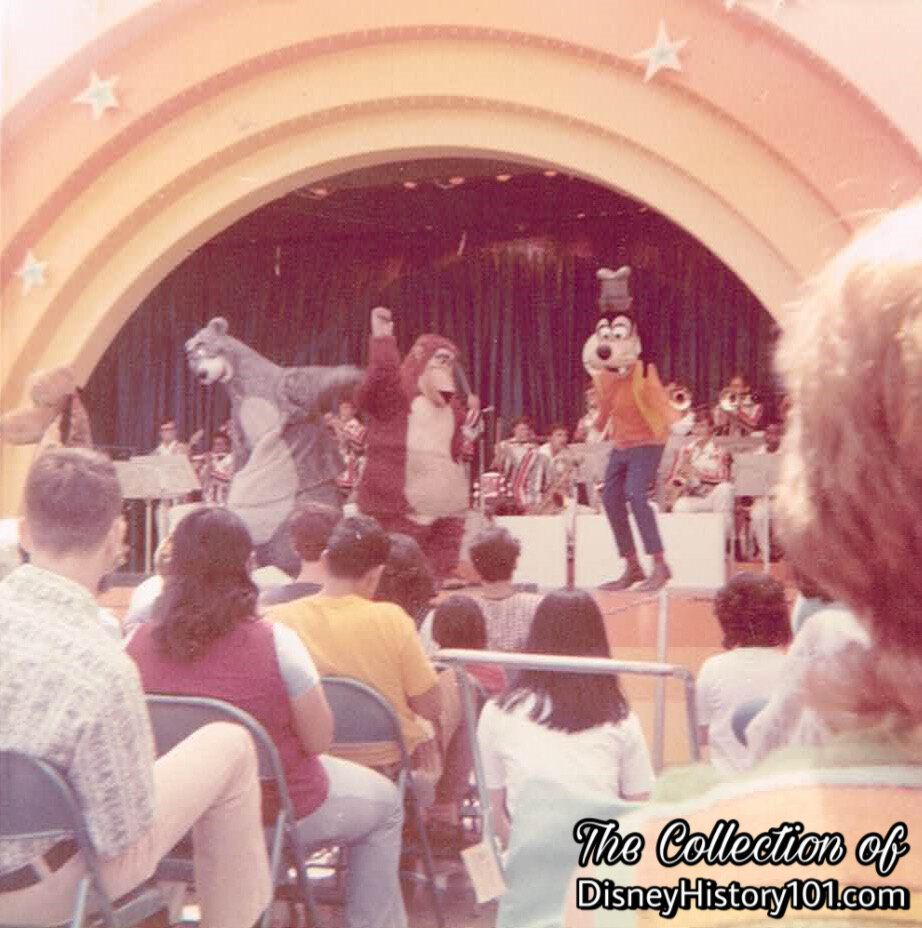
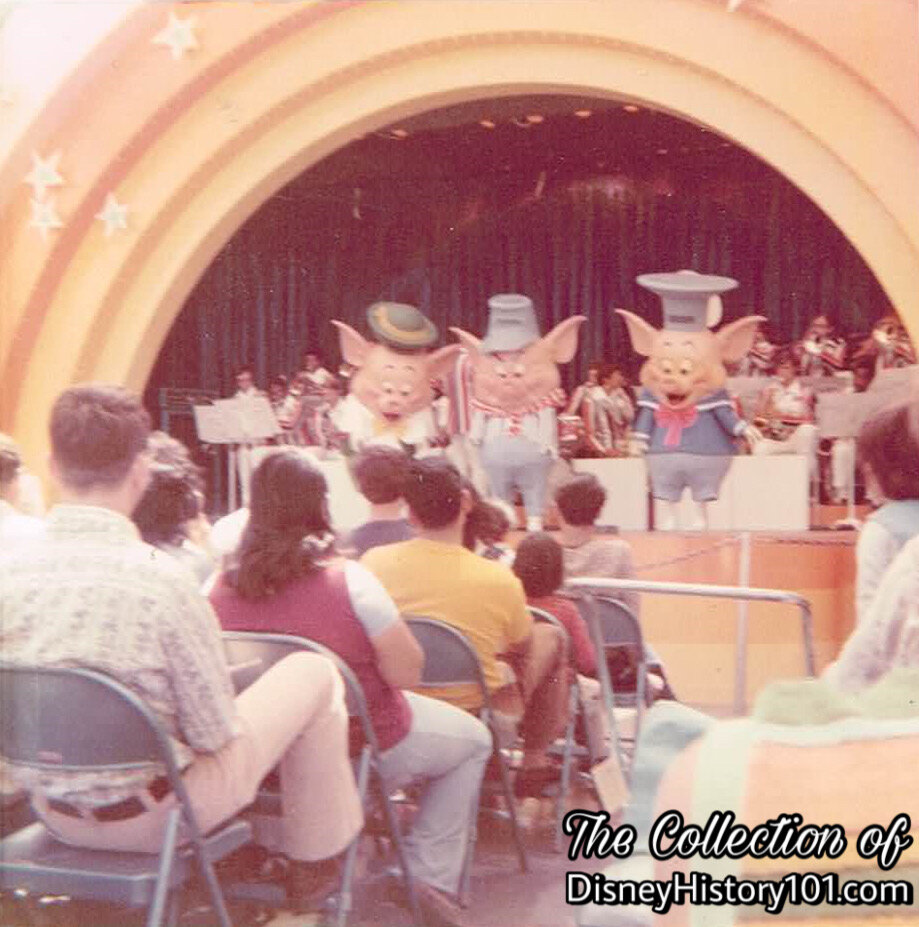
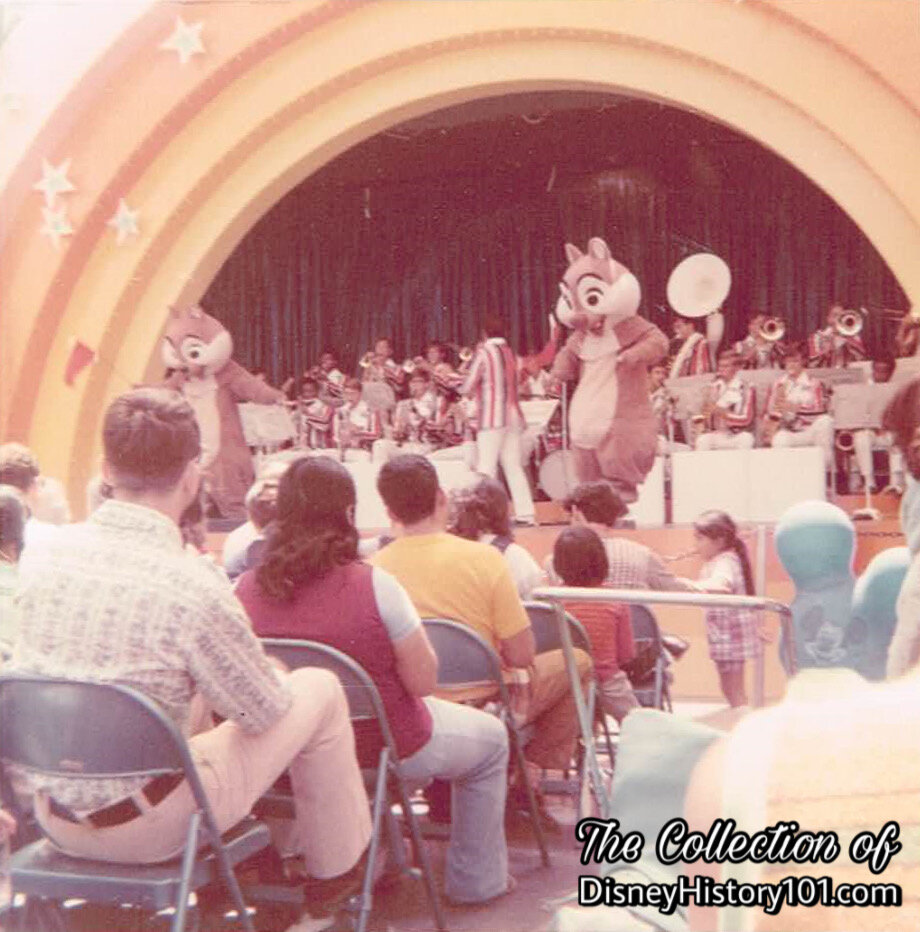
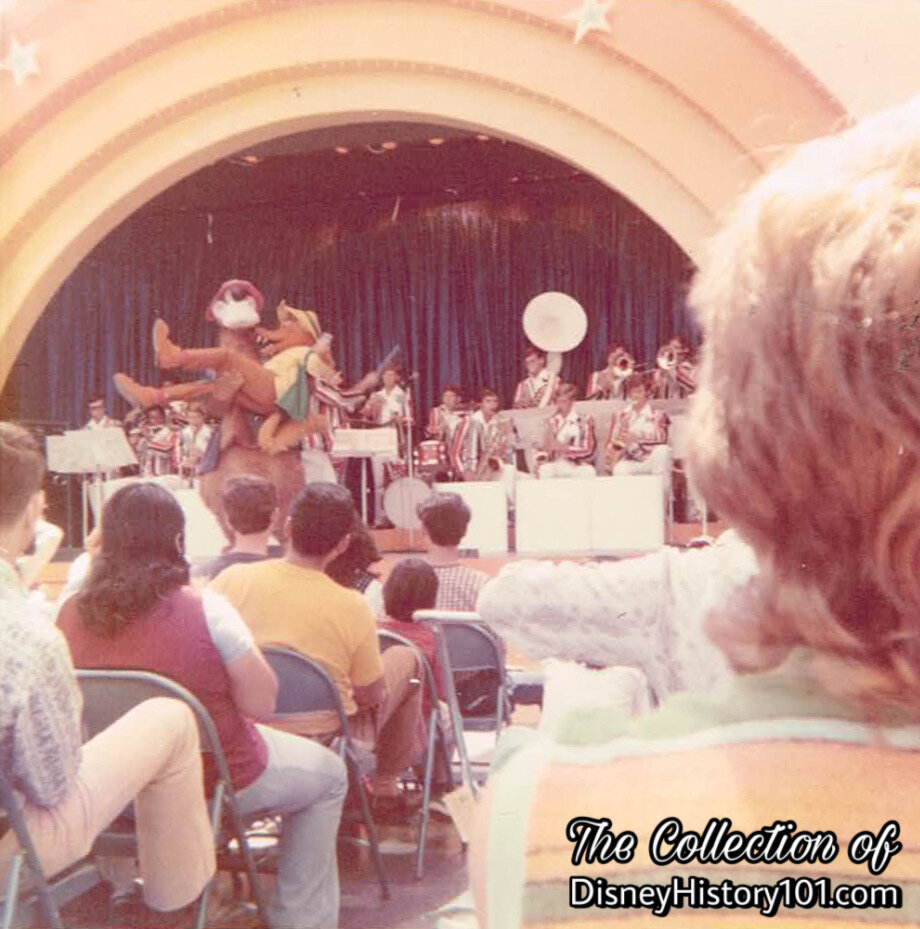
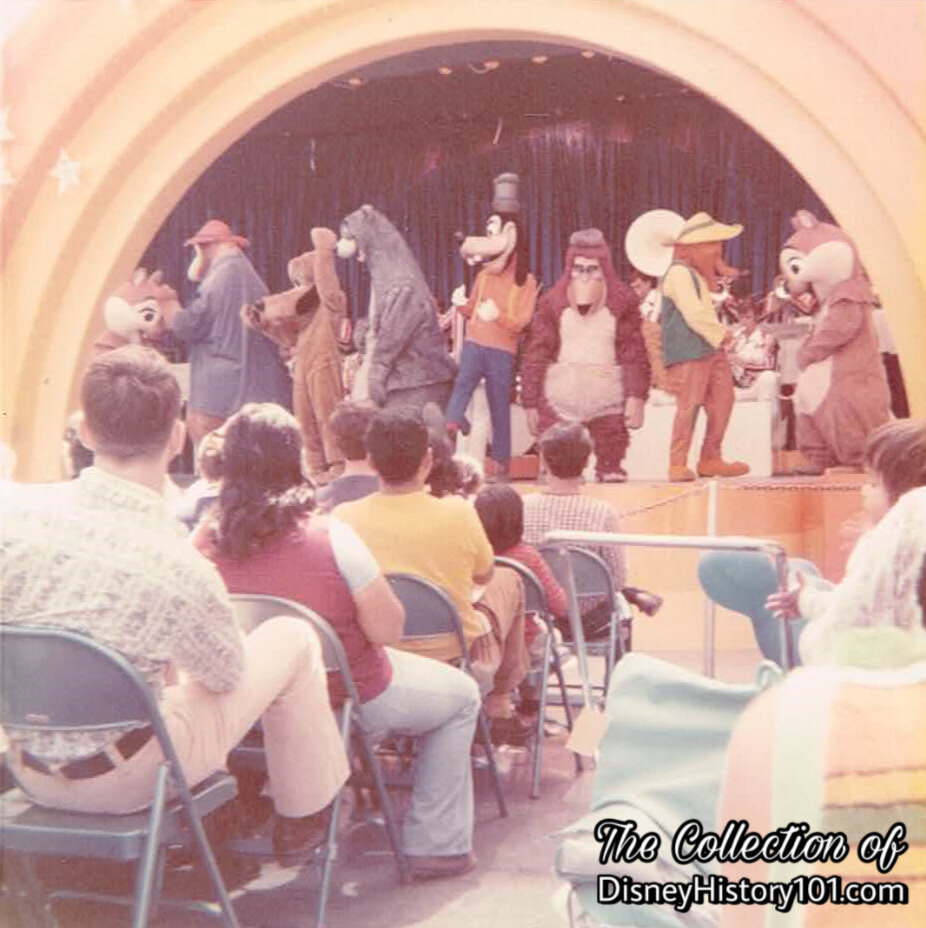

Many popular musicians performed from the Tomorrowland Stage! Now, let’s take a look at just some of that big-name talent - the “stars” of the Tomorrowland Stage!
In the following section we’ll attempt to chronicle the Tomorrowland Stage’s performers by the year of their occurrence!
1967 : During the winter season of 1967, you may recall the exciting sounds of Randy Sparks and “Back Porch Majority” emanating from Tomorrowland Stage for five shows daily (12:00N-6:00pm) and The Mustangs performing “the top songs of the hit parade” (for four shows daily), from December 26th, 1967 thru January 1st, 1968. During the time, the exciting vocal group “The New Establishment” performed popular songs during seven shows daily (from 12:00N - 7:00pm). [“Disneyland Holiday Talent Master Schedule,” prepared for the period of December 16, 1967 through January 1, 1968]
1968 : The summer of ‘68, Tomorrowland Stage was host to four variety shows daily. There was an “18 member group comprised of talent drawn from colleges and universities” and a Special Vaudeville Show featuring headline talent and variety acts, Monday thru Friday. Disneyland “Spring Fling” (occurring April 6th, 1968) brought The Mustangs (with Special Guest Bobby Vee) to the Tomorrowland Stage! The Country Music Jubilee of 1968 (starring Noel Boggs and His Band, Harry Newman, Brad Melton and Cathie Taylor, with guest MCs) had three shows daily, performed at 3, 5, and 7. On August 12, 1969, the true-life Apollo Moon Landing was watched live with the help of a giant screen on the Tomorrowland Stage.
During 1968, “On Stage USA” may have been presented from the Tomorrowland Stage. Acts included Jack Carter and Jaye P. Morgan (July 29-August 2), Phyllis Diller (August 12-16), Bill Dana & Theresa Brewer (August 19-23). During 1968, the “Country Music Jubilee” may also have been performed from the Tomorrowaland Stage with acts including Minnie Pearl (August 4), Roy Clark (August 11), Judy Lynn Show (August 18), and Horner & Jethro (August 25).
1969 : The Tomorrowland Stage also hosted dancing and live bands during Spring Fling 1969! Sunday June 29th brought the Country Music Jubilee (starring Homer & Jethro, Charlie Louvin & The Gang, and Cathie Taylor, with guest MCs). Shows were performed at 3, 5, and 7. Henson Cargill performed one night - Sunday, June 6th.
Without a doubt, the most momentous event to ever occur on the Tomorrowland stage was the viewing of an event which was occurring some 238,900 miles away - that of the Apollo Moon Landing, on July 20, 1969. This was the very same Apollo mission on which Astronaut Gene Cernan wore his Mickey Mouse watch. The entire event was broadcast live on the Tomorrowland Stage (the future site of Space Mountain and Captain EO).
During the following days (July 21 - 25), On Stage U.S.A. ran, including Tony Martin, Shari Lewis, the Fuller Brothers, Patti Page, the Doodletown Pipers, and special guest musical director John Scott Trotter. Saturday, July 26th saw The Mar Cells perform live on stage. Later (during the summer), Shani Wallace, The Osmond Brothers, Bobbie Gentry, Roger Williams, Peggy Lee and The Vogues performed live on stage.
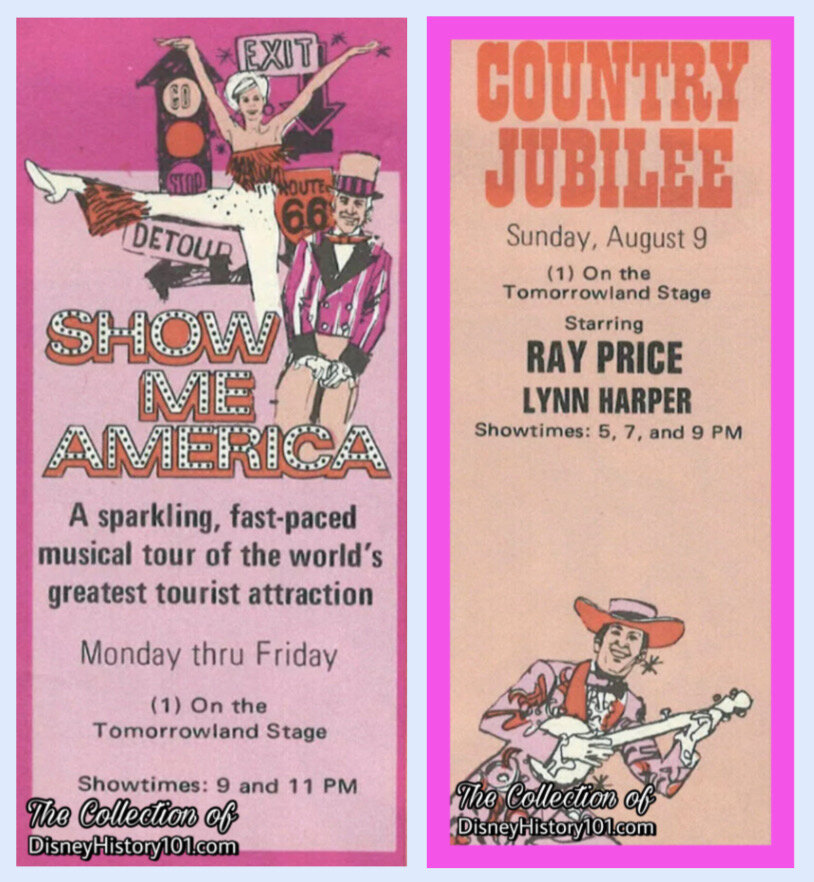
1970 : Even before Disneyland’s “Super Summer” was here - a veritable “Year of 100 Million Smiles,” plenty of top talent was scheduled! January of 1970 brought Doc Severinsen to the Tomorrowland Stage. While rock entertainers appeared Monday thru Friday, country and western entertainers appeared on Sundays! Kurt Russell introduced E.J. Peaker in a stage show (starring the Kids of the Kingdom and Sound Castle, Ltd.) featuring the Osmond Brothers, which was recorded (perhaps during February 27th, 1970) and incorporated into “Disneyland Showtime” (a Wonderful World of Disney episode, first aired March 22nd, 1970).
The Kids of the Kingdom (“15 of the most talented kids in the nation” who usually performed Monday thru Saturday, at 1, 2:30, 4, 5:30, and 7 p.m. during the summer of 1970), performed a special show in honor of Disneyland’s 15th Anniversary Birthday on June 22nd. Sound Castle Ltd. - “11 of the most talented entertainers” - also performed the world’s newest “mod music” for guests, on June 22nd.
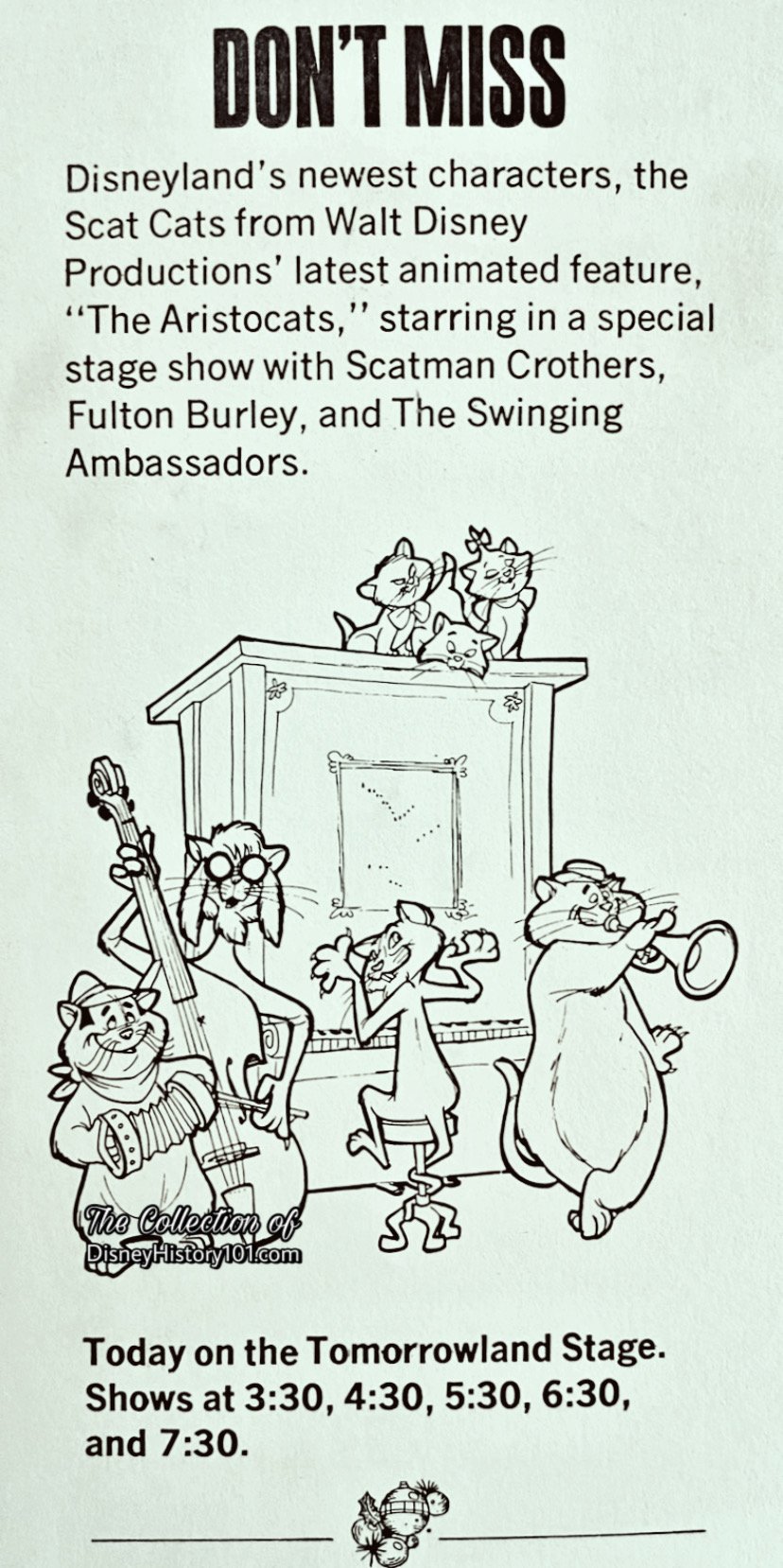
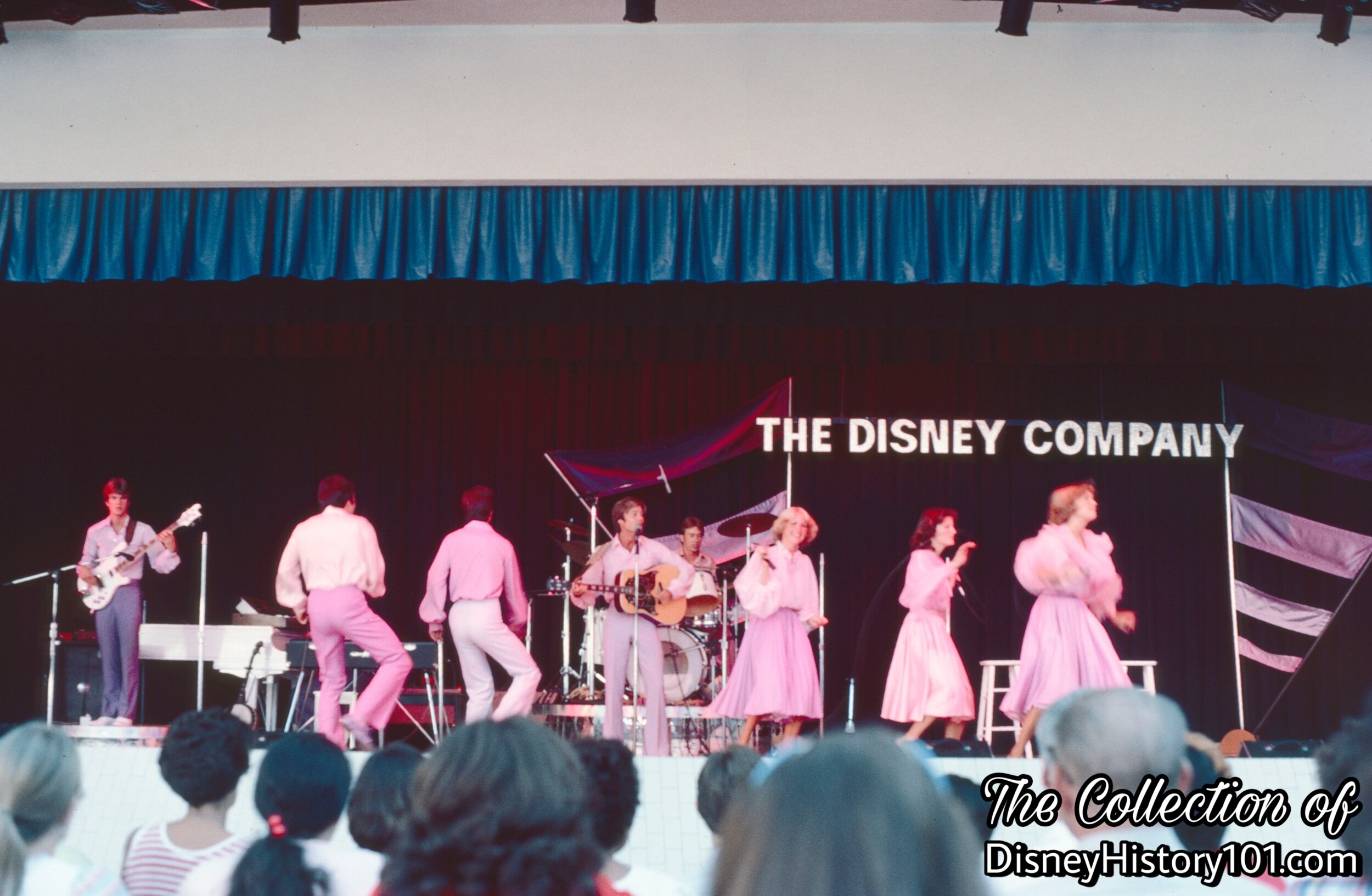
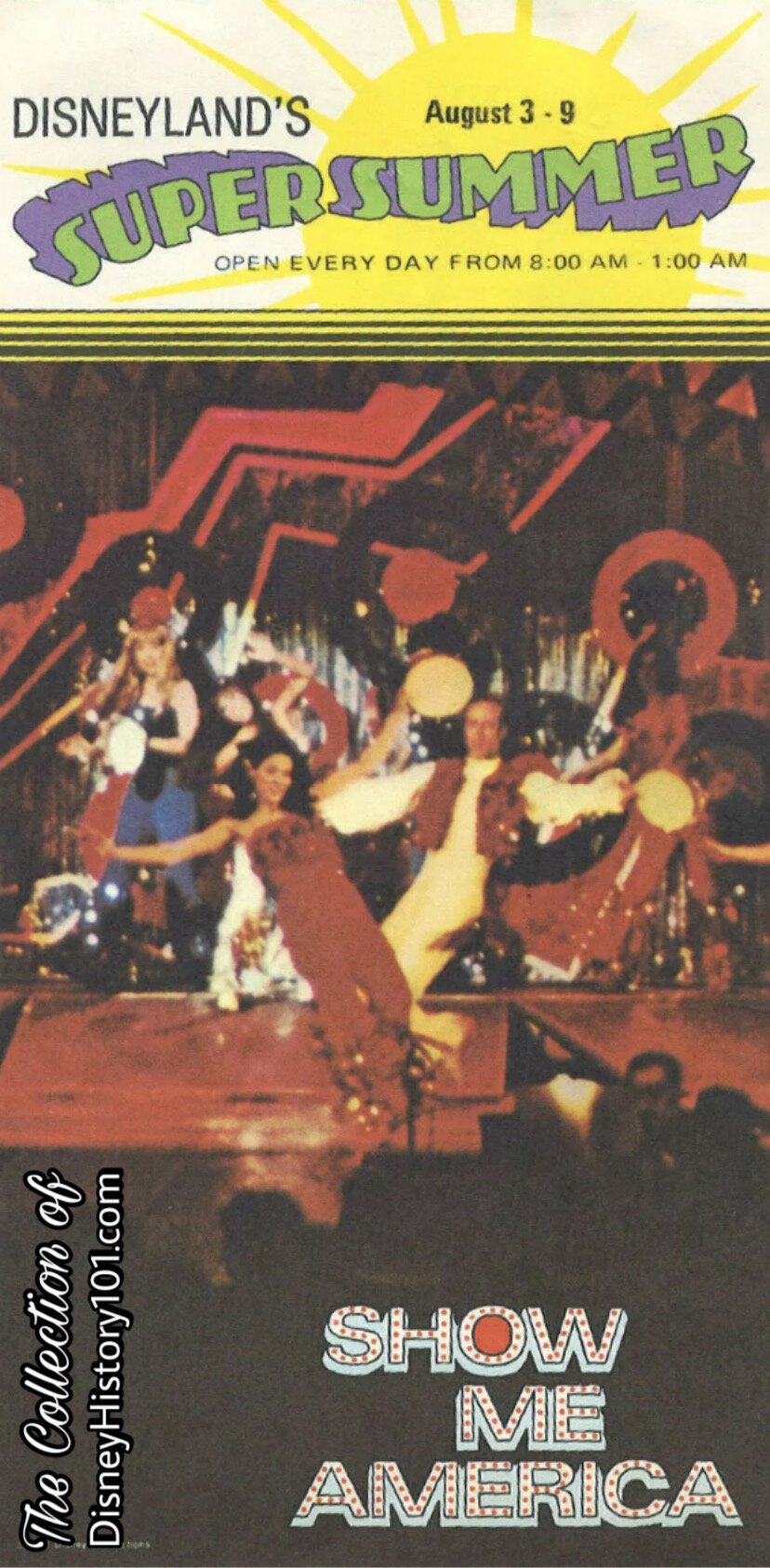
1970 (Continued) : “Show Me America” - “a sparkling, fast-paced musical tour of the world’s greatest tourist attraction”, Monday thru Friday on the Tomorrowland Stage, with two 45-minute shows occurring at 8 p.m. and 10 p.m., or 9 p.m. and 11 p.m. “Nearly 500 years after Columbus America has finally been fully discovered through the music and musings of the talented cast in this original, all-new production. Hang on for the wildest, funniest zip-trip ever experienced by the world’s top tourist treat, the U.S.A. The journey will take you to Old Broadway, Ellis Island, Boston, Chicago, The Great Divide, the Everglades, Biloxi, New Orleans, Nashville, Pattawahtamie, Center, Grand Canyon, Cowboy & Indian, Cucamonga, Freewayss, Niagra Falls, with a grand finale entitled ‘See America First’!” Show Me America stars John Wheeler (Phil), Karen Anders (Harriet), Sherry Alberoni (Diane), Terry Garr (the Statue of Liberty), and Jim Begg (Tour Guide), alongside a cast of seven “Guys” and six “Gals”, with music provided by the Show Me America orchestra under the Direction of Mr. John Scott Trotter! A total of 120 lavish costumes in addition to “spectacular stage settings” were provided for this production, by the Disneyland Entertainment Costuming Department! According to the Disneyland Diary, “60 members of the press led a standing ovation,” and by 124 performances, “the show was acclaimed by audiences and critics alike.”
A special show - Country Jubilee - starring Conway Twitty and Donna Fargo occurred Sunday, August 2nd, at 5, 7, and 9 p.m. Other talent signed on for 1970 included Roy Acuff, Buck Owens, Jerry Naylor, Susan Raye, Eddie Fukano, David Frizzelle, Tex Ritter, Dottie West, and the Stonemans. “Minority of Six” appeared one Saturday during the Summer of 1970, and the following Sunday on the neighboring Tomorrowland Terrace Stage.
The Scat Cats debuted at Disneyland during December of 1970. Disneyland's newest Characters, the Scat Cats from Walt Disney Productions’ latest animated feature, The Aristocats, starred in a special stage show with Scatman Crothers, Fulton Burley, and The Swinging Ambassadors. Shows were staged daily on the Tomorrowland Stage through the winter season (at 3:30, 4:30, 5:30, 6:30, and 7:30).
1971 : PREVIEW '71 (held Saturday, January 2nd) brought Rick Nelson, Dawn, and El Chicano.
During September 6-11, Bob Crosby and the greatest Dixieland band in the land, featuring the Bobcats plus an extra Added Attraction Dizzy Gillespie appeared on the Tomorrowland Stage at 9 p.m. and 11 p.m. and The New Dixie Rebellion appeared on the Tomorrowland Stage at 8 p.m., 10 p.m., and 12 midnight.
Later in 1971, Patti Page returned.
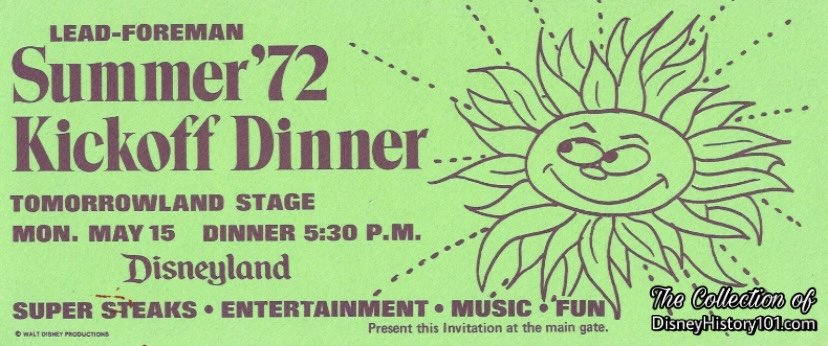
1972 : “It’s New, It’s Now… ” it’s “a whole new day after dark” on the Tomorrowland Stage!
June 3, 1972 Tomorrowland Stage Show was the site for Robert John and Helen Reddy. The Tomorrowland Rock Group and The Kids Next Door played daily during the daytime (as during June-July). Stevie Wonder, Helen Reddy, and Robert John performed during June. Tommy Roe performed nighttime (July 2-7). During the evenings of the summer of 1972, Climax featuring Sonny Geraci (June 18-23), The Raiders featuring Paul Revere and Mark Lindsay (June 25-30), Tommy Roe (again from July 9-14), Bill Medley (July 9-14), Dawn featuring Tony Orlando (July 16-21), Gary Puckett & The Union Gap of “Woman, Woman” fame was introduced by The Great American Music Machine Starring Freda Payne (nightly at 10:00 p.m., July 23-28), and Honey Cone (July 30-August 4) performed on the Tomorrowland Stage, with more guest stars to follow in August! El Chicano also performed live from Tomorrowland Stage.
A Guest Vaudeville Act performed at 12:30 PM, 1:00 PM, 1:30 PM, and 5:00 PM during Senior Citizens Days, October 12 and 13, 1972.
Plaza Gardens closed for three weeks for a rehab beginning Monday, November 27, 1972. During that time, Disneyland Band concerts were held on Tomorrowland Stage.
1973 : During Star Spangled Holidays (held February 17, 18, 19, 1973), Young Americans, Doc Severinsen and The Now Generation Brass featuring Today's Children, and The Sunshine Balloon w/special guest star performed from Tomorrowland Stage. Disneyland’s “New Sights and Bright Lights” included guests rock groups during the summer of 1973! The New Mickey Mouse Club Jamboree starring the New Mouseketeers performed four shows daily (1:30, 3:00, 4:30, and 6:00 p.m.), Monday thru Saturday. The Great American Music Machine starring Flash Cadillac & the Continental Kids also performed two shows during the evenings of the summer of 1973. Buddy Rich and Maynard Ferguson performed from Tomorrowland Stage during October of 1973.
1974 : “The Great Rock Circus” brought many “now-sound” entertainers to the Tomorrowland Stage throughout the summer. The Spinners (June 15-21), The Main Ingredient (June 23-28), Peter Noone (June 30-July 5), Rufus and Carla Thomas (July 7-12), Bo Donaldson and the Heywoods (July 14-19), Ann Peebles with Little Archie (July 21-26), Wilon Pickett (July 28-August 2), The Miracles (August 4-9), the Hues Corporation (August 11-16), The Association (August 18-23), and The Four Tops (September 1-7). The Carpenters and Skiles & Henderson performed on the Tomorrowland Stage during a Trojan Rally event on December 19, 1974. Flash Cadillac & The Continental Kids performed New Year’s Eve of 1974.
1975 : The Kids of the Kingdom and the All-American College Singers combined for a stage show during Disneyland’s Bicentennial Celebration! Bo Donaldson & the Heywoods during the America on Parade event, during the week of August 17-23, 1975.
1976 : June 27 through July 2, 1976, the popular soul performers Blue Magic appeared on the Tomorrowland Stage! During Disneyland’s “Celebration Summer” (and the week of June 22-28, 1976, Cuba Gooding and the Main Ingredient performed at 9:05 p.m. & 11:30 p.m.
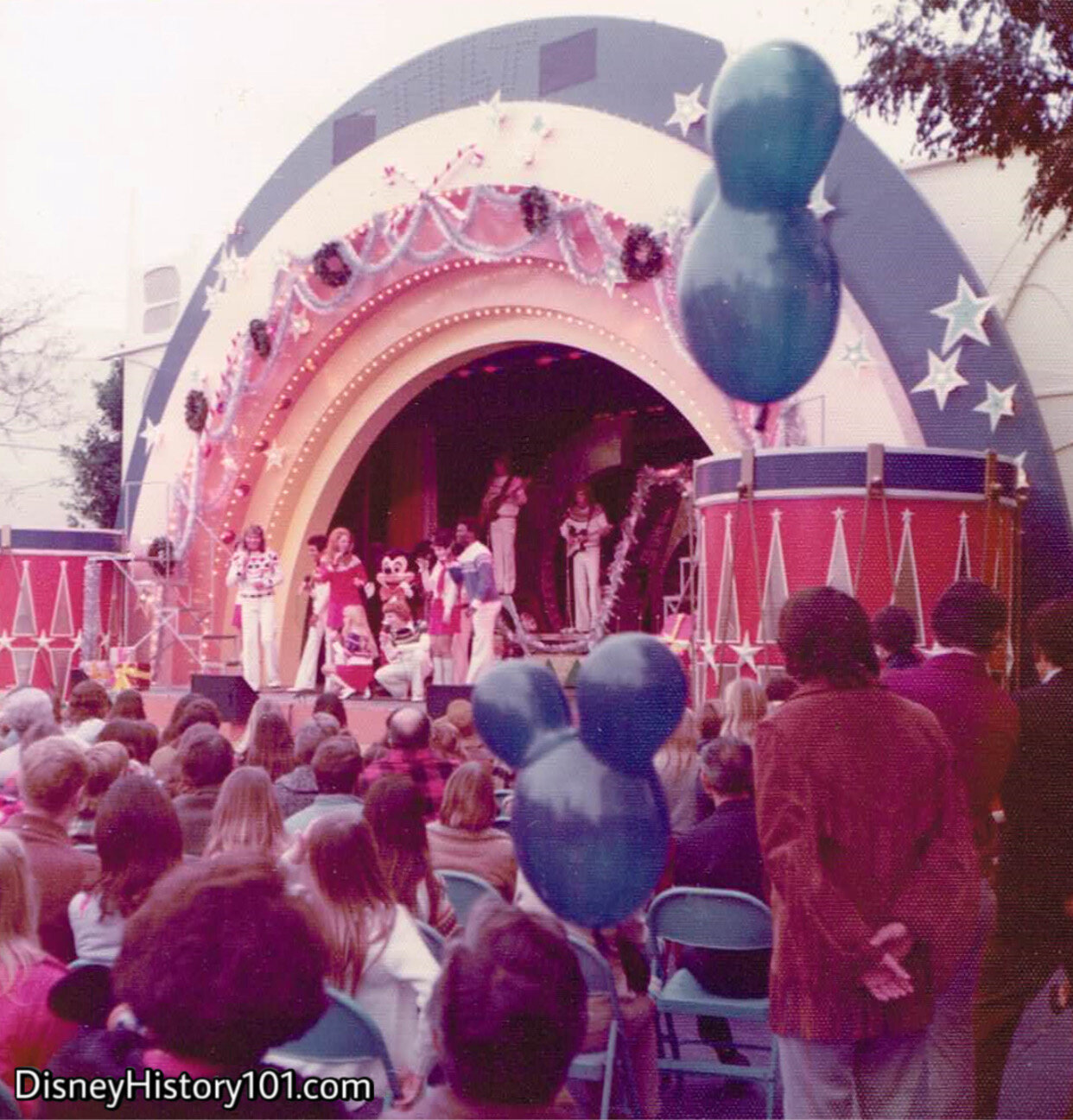
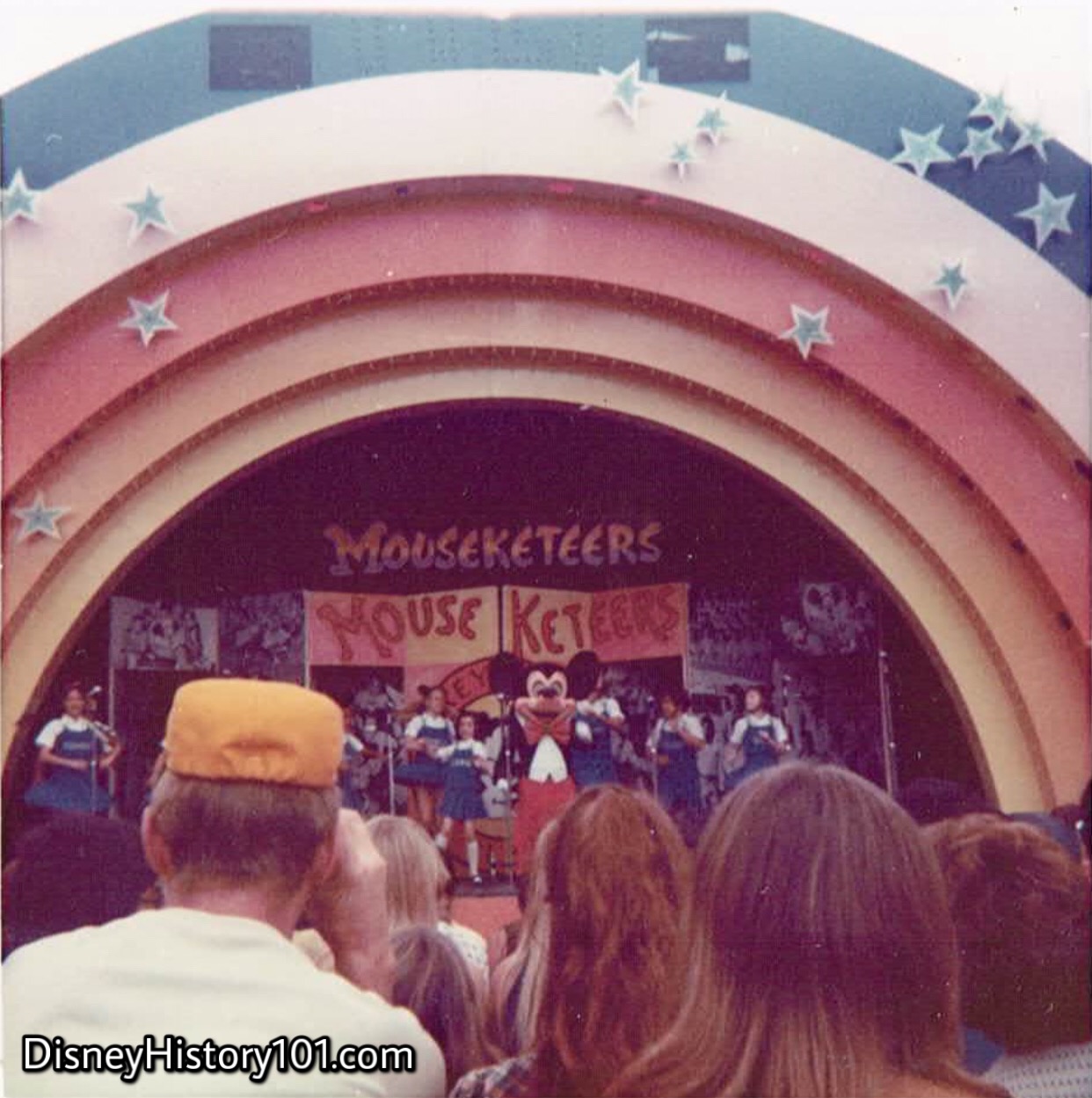
The New Mouseketeers Show entertained audiences on June 29, 30, July 1, 1978.

The Tomorrowland Stage was just too good of a dream come come true. A form of the stage would materialize as the Theater of the Stars at Disney-MGM Studios in 1993. Even before that time, when Space Mountain was being master planned and realized, an exciting new stage would be built practically on the foundations of the original Tomorrowland Stage at Disneyland! The new stage would appropriately be named…
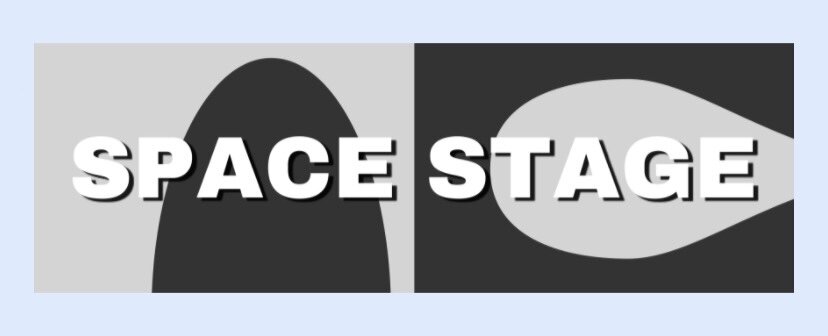
The 1,100-seat Space Stage opened (along with Space Mountain, the adjacent Space Place restaurant, and the Starcade) during 1977!
1977 : The Space Stage opened with acts popular like the New Mouseketeers (Lisa Whelchel, Curtis Wong, Kelly Parsons, Allison Fonte, Nita Dee, Mindy Feldman, Angel Florez, Shawnte Northcutte, Scott Craig, Todd Turquand, Julie Piekarski, Pop Attmore). These appeared (with Space Mountain) during the summer off 1977.
1978 : It was “showtime” and “get-up-and-go-time” as the members of the New Mickey Mouse Club often made promotional live performances during the era contemporaneous with its late 1970s televised run (appearing during both the summer of 1977 and the summer of 1978 inside Disneyland). The New Mouseketeers Show again entertained throngs of cheering Disneyland guests on June 29, 30, and July 1, July 30 - August 5, 1978. The Kids of the Kingdom starred in a separate daytime show during this period. September 3-9, 1978, The Magnificent Music ‘N’ Motion Machine Starring Papa Doo Run Run and Lite Fantastic delighted guests daily Monday thru Saturday, at 8:15 p.m. and 12:30 a.m. The All American College Singers and the Kids of the Kingdom performed during four shows (during afternoons during July 30 - August 5, 1978), while The Magnificent Music ‘N’ Motion Machine starring Papa Doo Run Run and Lite Fantastic performed three shows (11:00 a.m., 12:30 & 1:30 p.m.) in the morning and early afternoon. The Peter Marshall Show with Chapter 5 performed December 17-23, 1978. The Mouseketeers also performed daytimes during the holiday season of December 19-23. The Jo Ann Castle Show with special guest Fats Johnson took to the Space Stage from December 26 thru 30, 1978.
Other performers (during 1978) included Rick Nelson and The Stone Canyon Band, The Heywoods, Cornelius Bros. & Sister Rose, and Sunshine Balloon.
1979 : MECO (of Star Wars Disco fame) rang in the new year, performing from 8 p.m. to midnight January 1, 1979. March 24-30, the Mike Curb Congregation performed during the days leading right up to Easter Sunday. The Miracles and Blue Swede also performed twice nightly from March 24-29. The Kids of the Kingdom presented “The Best of Disney” on Mother’s Day, May 13th.
1980 : Mickey Mouse Club 25th Anniversary Revue - “a singing and dancing celebration” of the Mickey Mouse Club’s 25th anniversary with original Mouseketeers Tommy, Cubby, Sharon, Lonnie, Bonnie, and Sherry! Other entertainment during Disneyland’s “silver summer” included disco dancing on Friday and Saturday nights. The Kids of the Kingdom entertained with a special production of “Disneyland Is Your Land” on Sunday nights ; “The Disneyland Story” performed for five shows Sunday only, from 11:30am to 4:30pm ; The Skiles Band (Mondays & Tuesdays) ; Pizzazz (Sundays, Wednesdays, and Thursdays) ; Matthew Wilder ; Dazz Band ; Jan and Dean (backed by Papa Doo Run Run) brought the sounds of Surf City to the Space Stage from 8 p.m. to 10 p.m. during August. At some unknown time, Asleep at the Wheel with special guest star Lacy J. Dalton performed.
1981 : Show Biz Is - Festival of Japan (March 28 & 29) brought Tanekayuma (Snake Dancers), Tokuyae Classical Dance Group (one of the few groups to perform during the 1950s at Disneyland), Wakabakai Dance Academy, Wakao Dance Academy & Fujike Kirihara Music School, Tandawaha Dance Company, and Mityusa Bando dancers.
“A big bright musical revue from Broadway to Hollywood and a few surprises in between” - ran three times daily, during afternoons of 1981. The (c. June, 1981) show was described as a “new singing, dancing, salute to the worlds of Hollywood, Broadway, Big Brass Bands, and the Big Top.” Sing!Dance!Disney! was “a medley of popular Disney tunes presented live by a group of energetic Disneyland performers”! Michael Iceberg & the Iceberg Machine, Krash, and Papa Doo Run Run performed during daytimes and evenings.
Truly, the highlight of all shows came when Halyx debuted their “unearthly sights and outrageous new rock sounds” from the Tomorrowland Stage (from June 20th-September 11th) during the summer of 1981. This act (of humans, extra-terrestrials and artificial intelligence) is something that needs to be seen to be believed!
1982 : Disneyland Easter Party brought Peaches and Herb to the Space Stage (April 3-10, twice nightly, at 8:30pm and 10:30pm.
1983 : February 12 & 13, 1983 the L.A. Lazers - a professional indoor soccer team - demonstrated their skills on the Space Stage in Tomorrowland during afternoons at 1:30 and 3:00 p.m. “Show Biz Is” - a “singing dancing salute to the world’s of Hollywood, Broadway, Big Brass Bands and the Big Top” - ran three to four times nightly, typically Sundays thru Thursdays. February 19 & 20, 1983, Sonny Charles, and Maxine Nightingale performed. Papa Doo Run Run (March 26, 27, 28), Scott Baio with Jay Johnson & Bob (March 29, 30, 31) ; Jack Mack & the Heart Attack (April 1 & 2) performed multiple shows nightly.
1984 : “Come along and sing a song and be a Mouseketeer again” with The Mickey Mouse Club starring the Original Mouseketeers. Some of your favorite original TV Mouseketeers are getting together top sing, dance, and “remember when” with Mickey in this happy stage revue. In addition, Jose Feliciano, the DeFranco Family, and the Mike Curb Congregation performed during late December (the latter made five appearances daily, for nine days)!
1985 : Miami Sound Machine and Gloria Esteban
Year Unknown (c. 1990s?) : Disneyland Country Weekend (February 12, 13, and 14 brought Kay Austin Show and the Moonshine Cloggers to the Space Stage in Tomorrowland for three shows each during the daytime! During the nighttime, Porter Wagoner, Mel Tillis, Charly McClain, and Boxcar Willie each performed three shows!
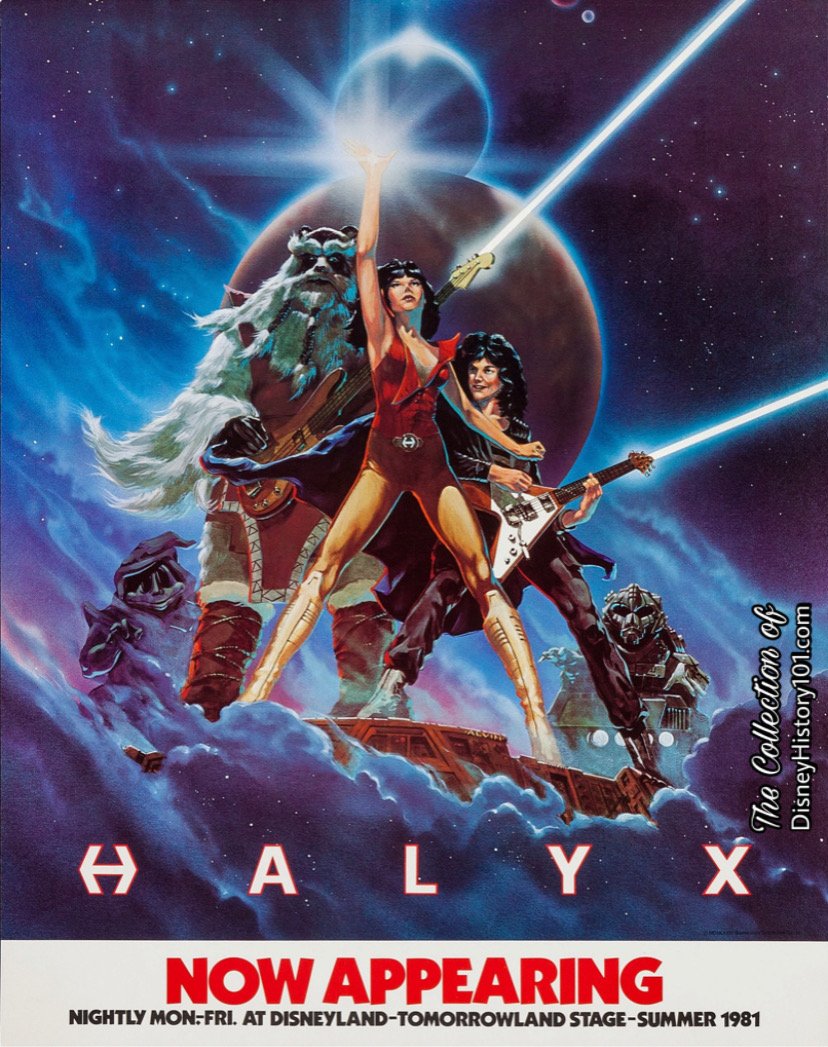
There is a fantastic in-depth documentary entitled “LIVE FROM THE SPACE STAGE : THE HALYX STORY” (A Matthew Serrano Film, Presented by Defunctland), which was released in 2020. The hour-and-a-half film tells the story of the band’s creation and performances with special appearances by the producer Mike Post and the surviving band members.
Sonny Anderson recommended notable Music Composer Mike Post (Hill Street Blues, Magnum P.I., The Greatest American Hero, The Rockford Files). The company that built the floats for the Main Street Electrical Parade created the vehicle for the keyboardist, by mounting keyboards and lights to a Cushman Minute Miser maintenance cart.
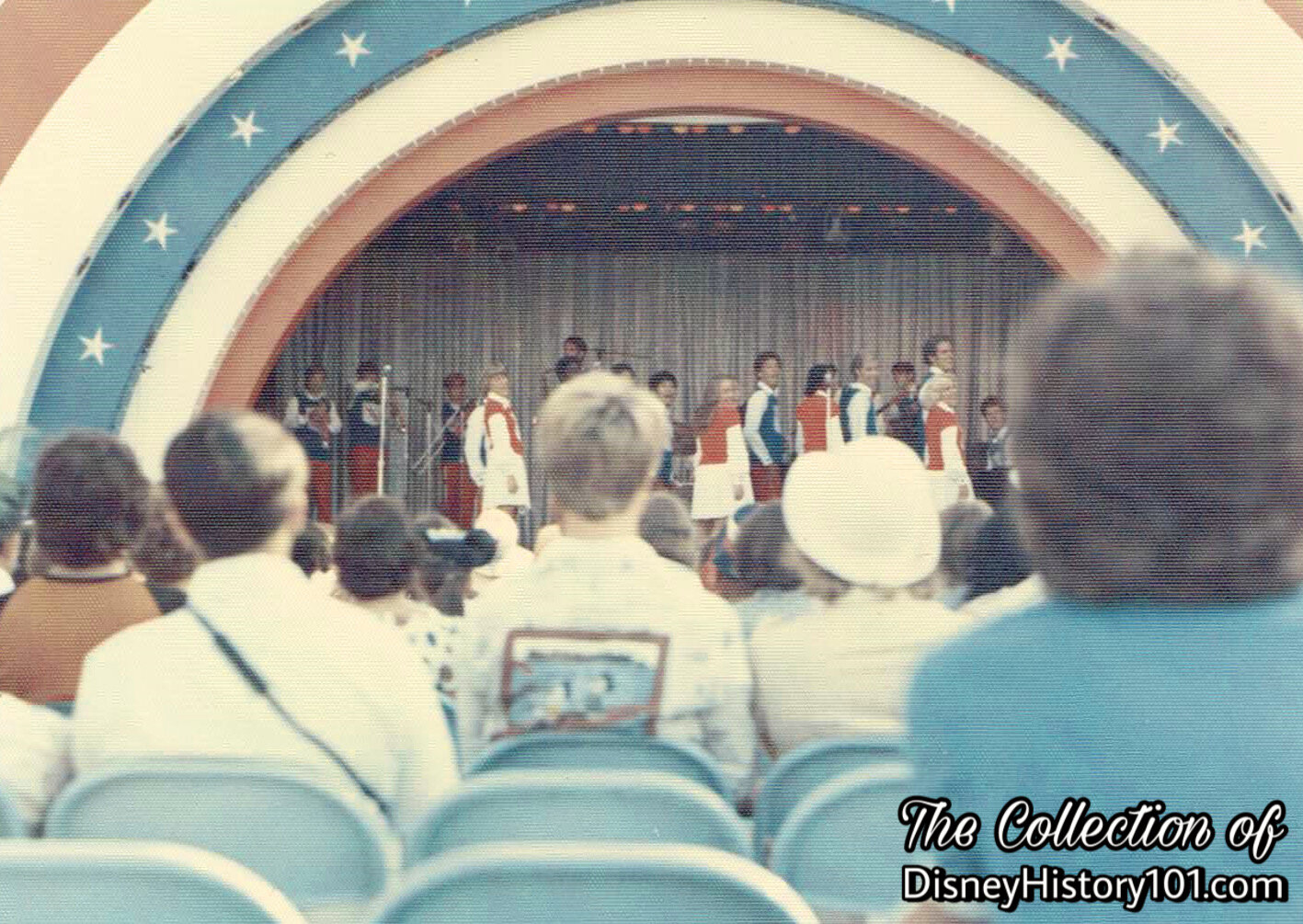

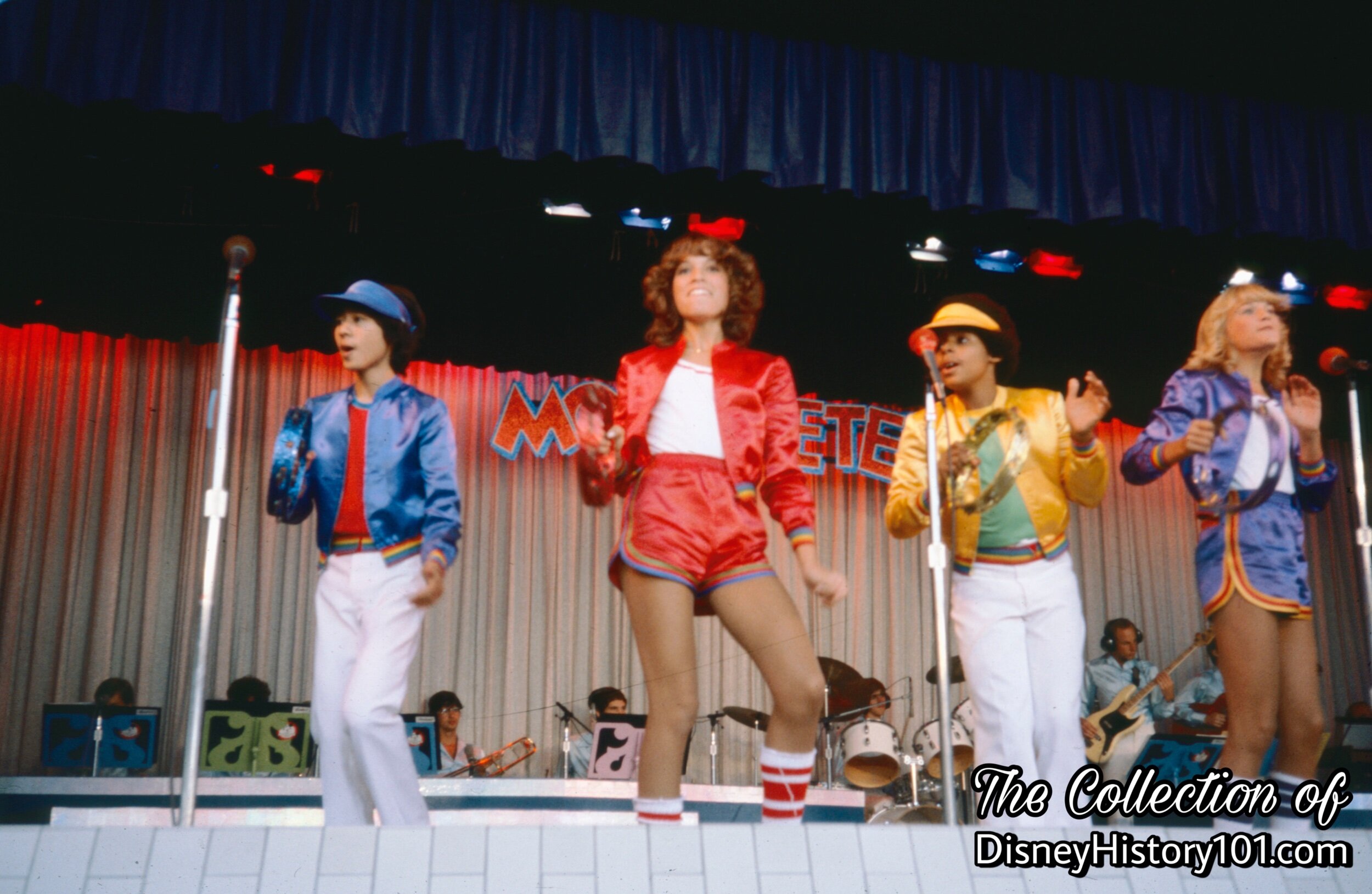
The members of the New Mickey Mouse Club often made promotional live performances during the era contemporaneous with its late 1970s televised run (appearing during the summer of 1977 and the summer of 1978 inside Disneyland). Here, a multicultural lineup - Curtis Wong, Allison Fonte, Billy “Pop” Attmore, and Kelly Parsons - perform “Disco Mouse” during “showtime”!
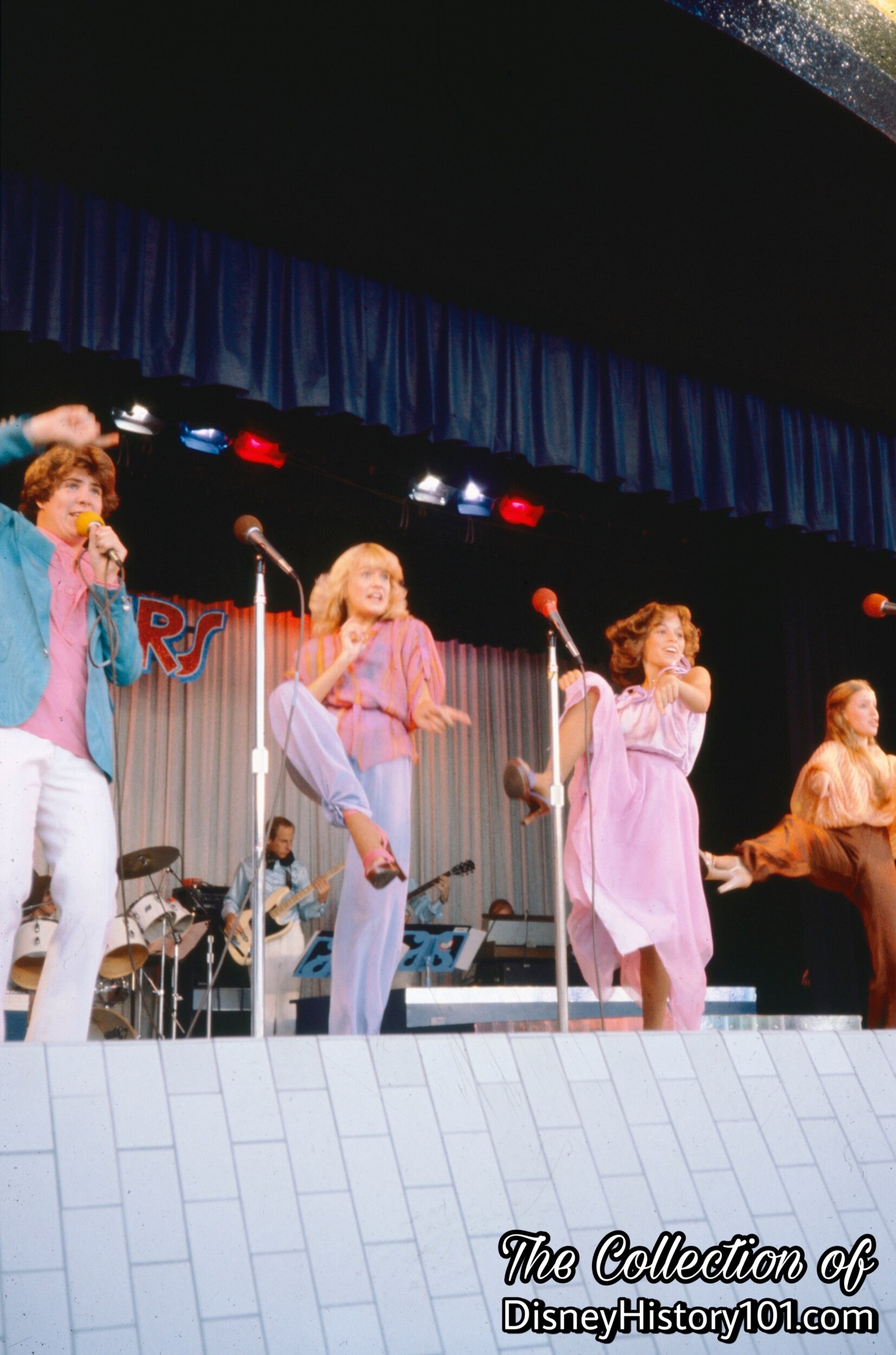
Scott Craig, Kelly Parsons, Allison Fonte, and Julie Piekarski are “dancing’ to the beat” and “movin’ their feet”.
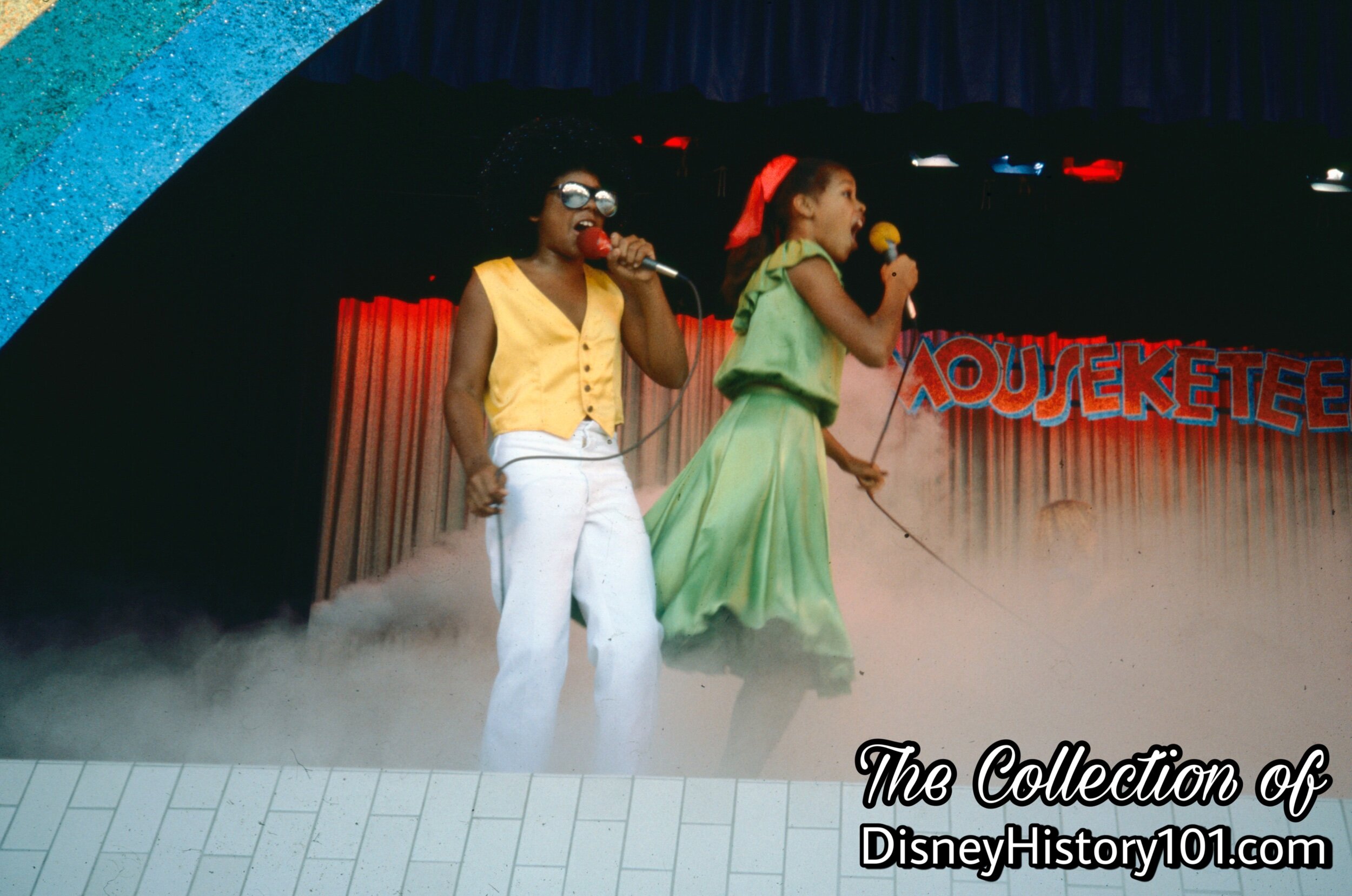
All-New Mouseketeers Billy “Pop” Attmore (of Treasure of Matecumbe fame) and Shawnte Northcutte (Miss Pre-Teen America 1975-1976).
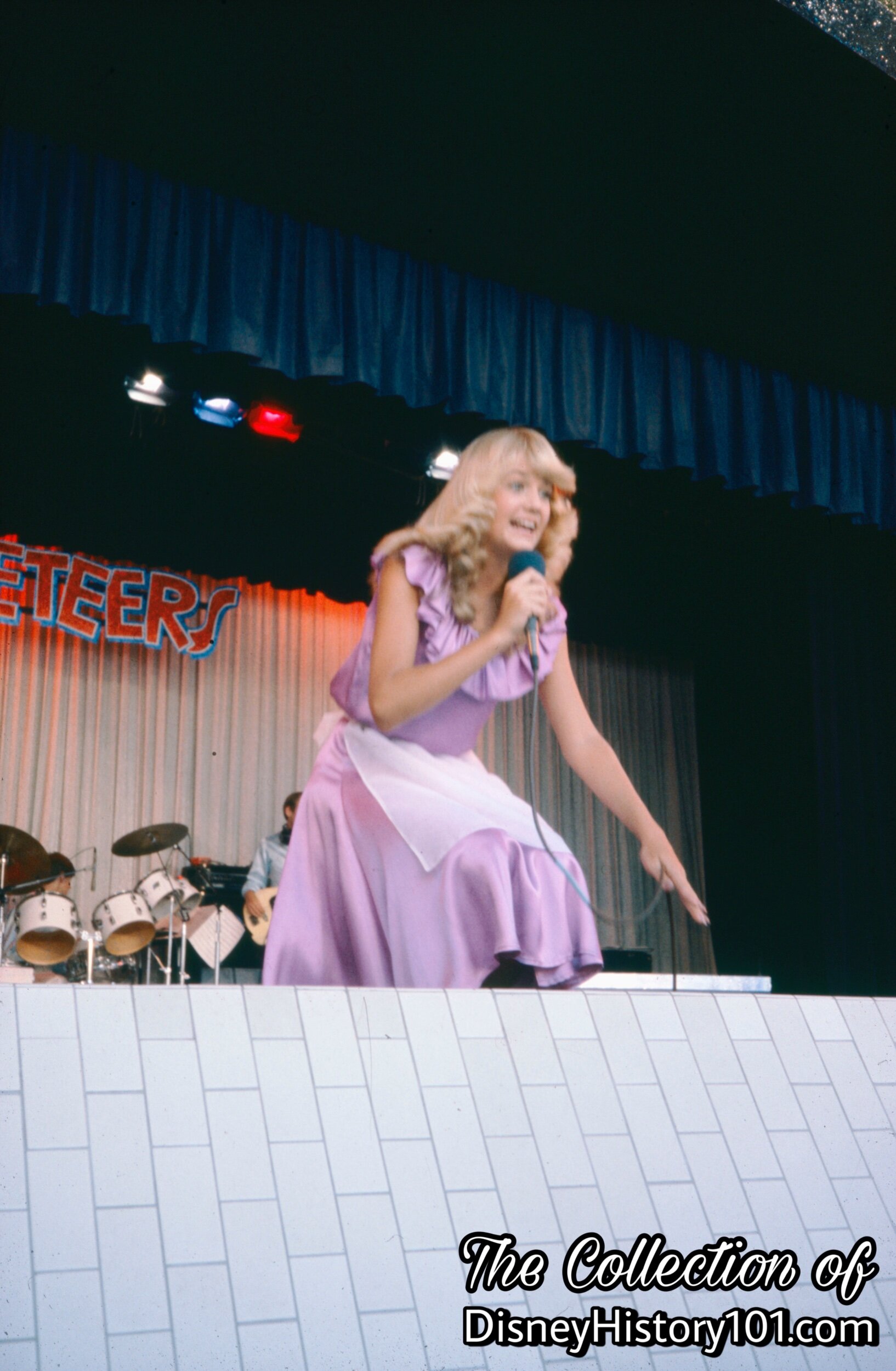
Lisa Whelchel
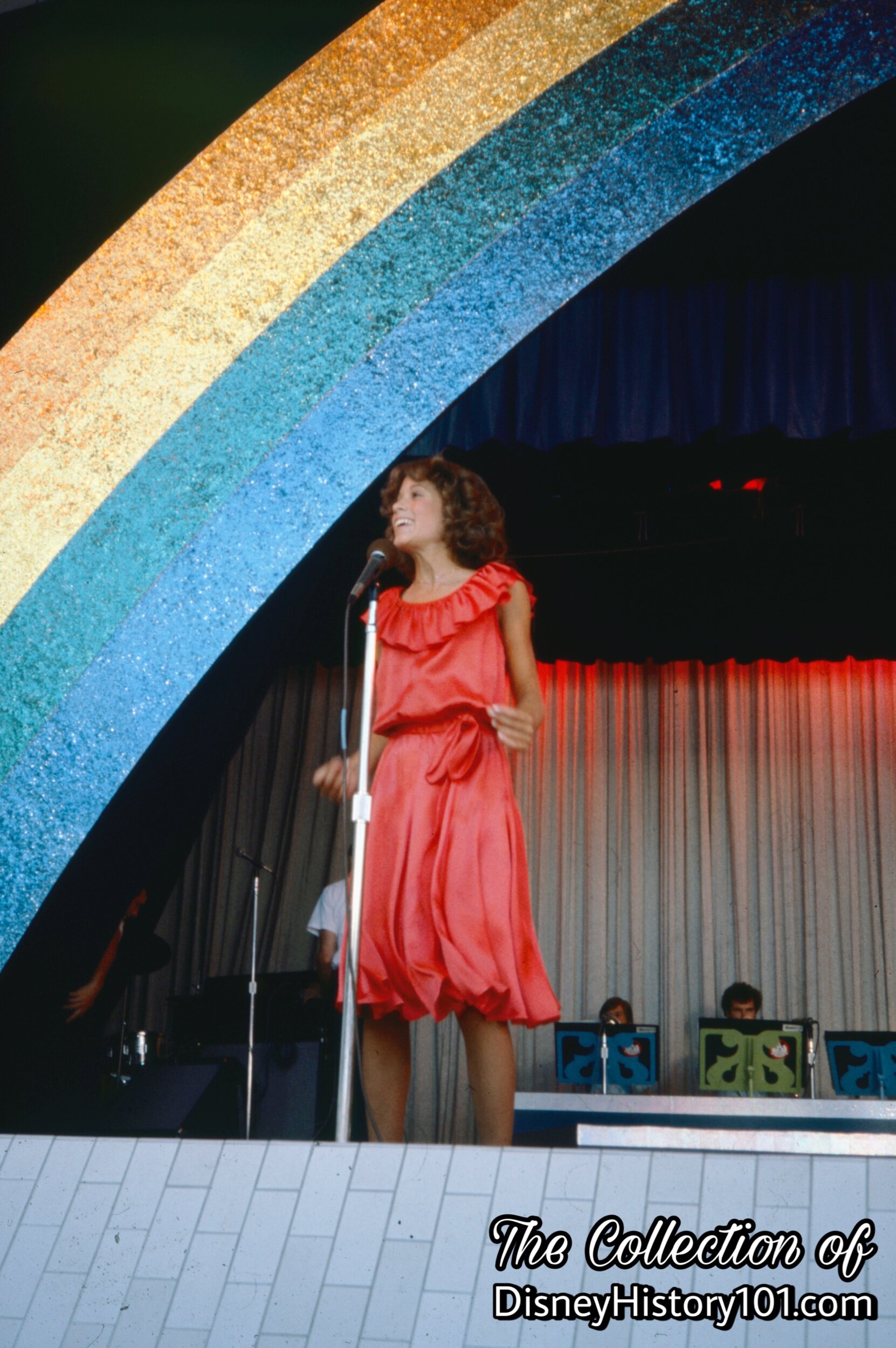
Allison Fonte
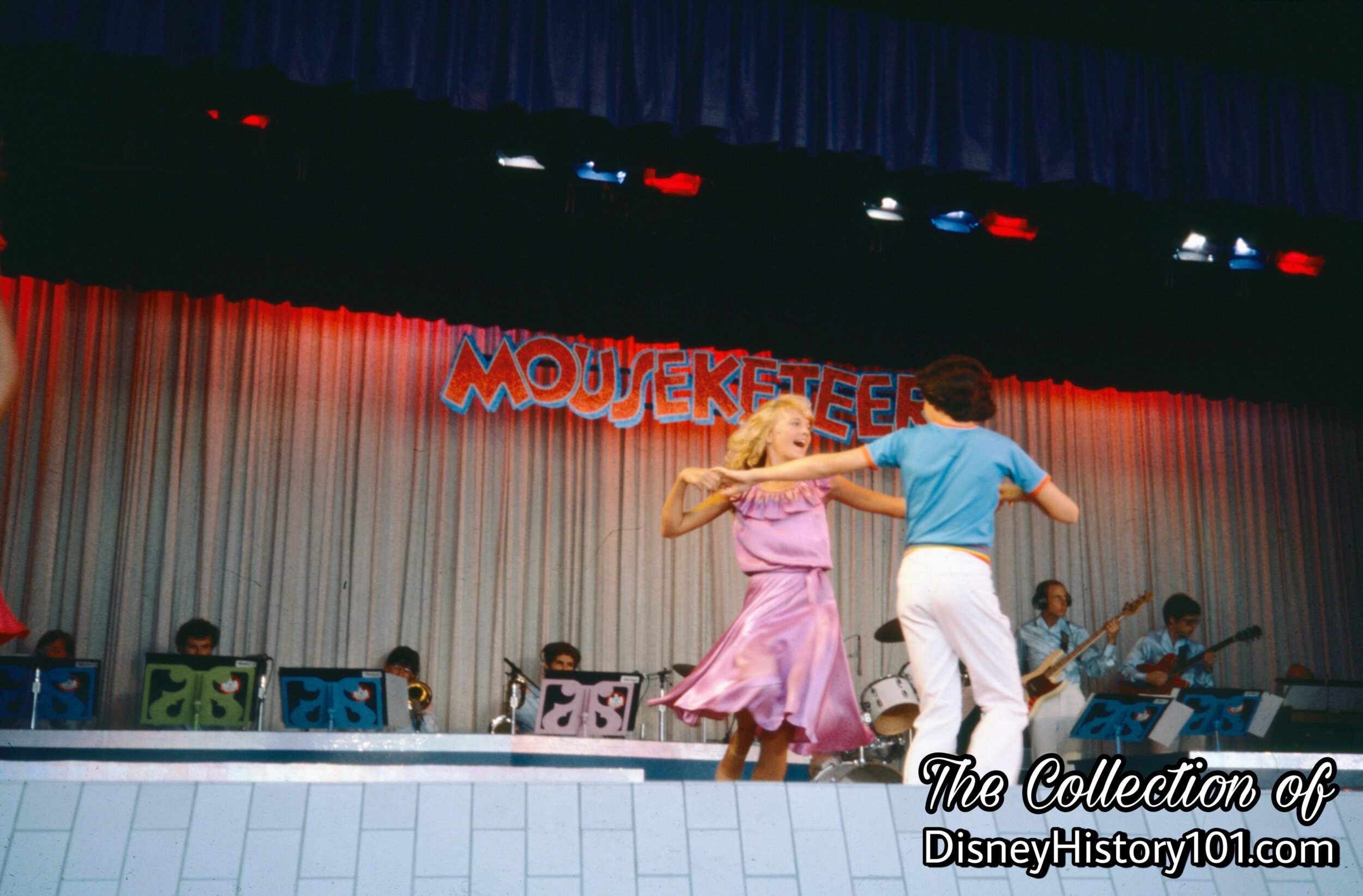
Kelly Parsons and Todd Turquond doin’ a Mouseke-Dance for the audience!
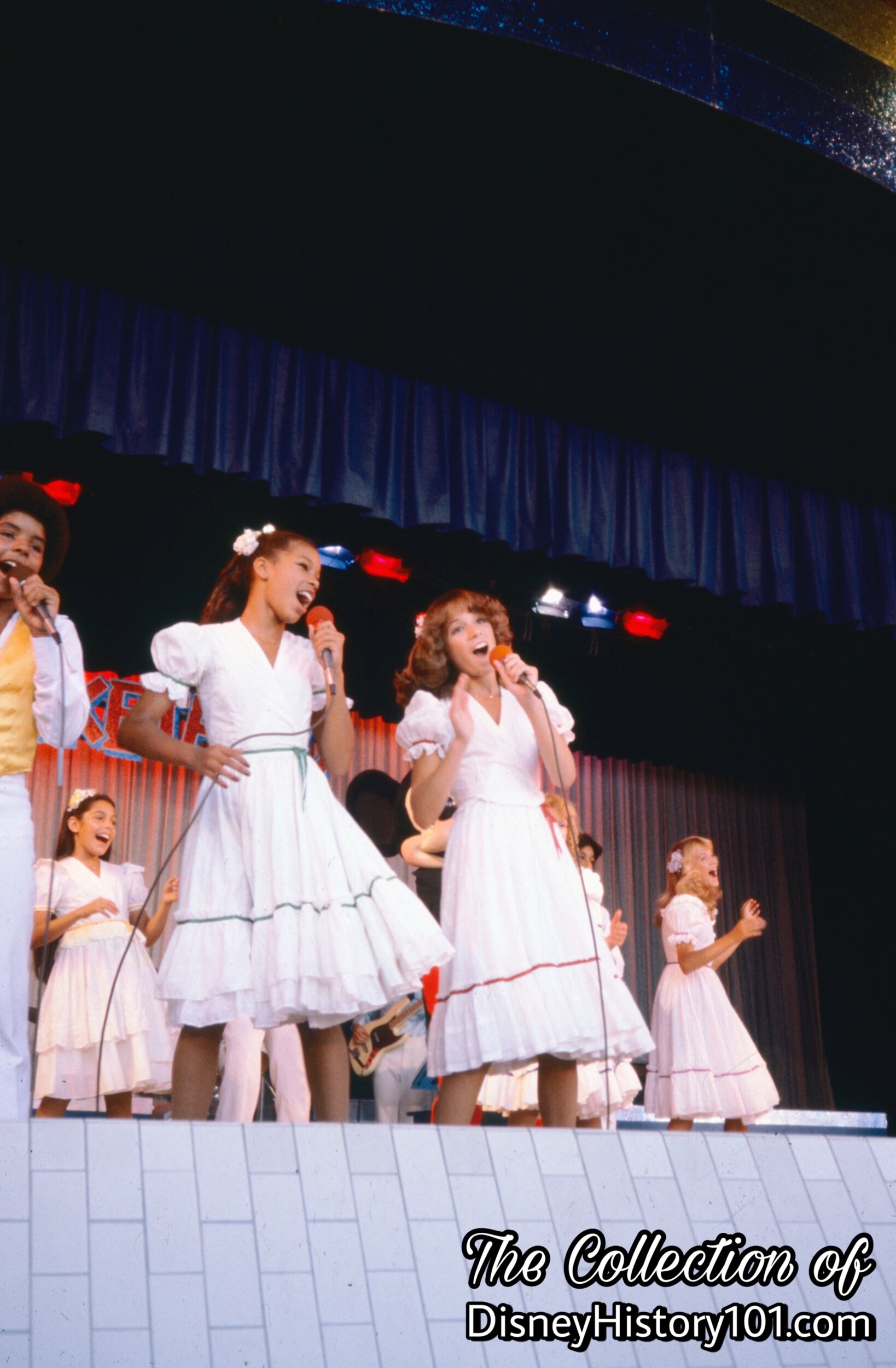
The members of the New Mickey Mouse Club often made promotional live performances during the era contemporaneous with its late 1970s televised run. From Left to Right : Billy “Pop” Attmore, Nita Dee (in the background), Mickey Mouse (in the background), Shawnte Northcutte, Allison Fonte, and Kelly Parsons (in the background).
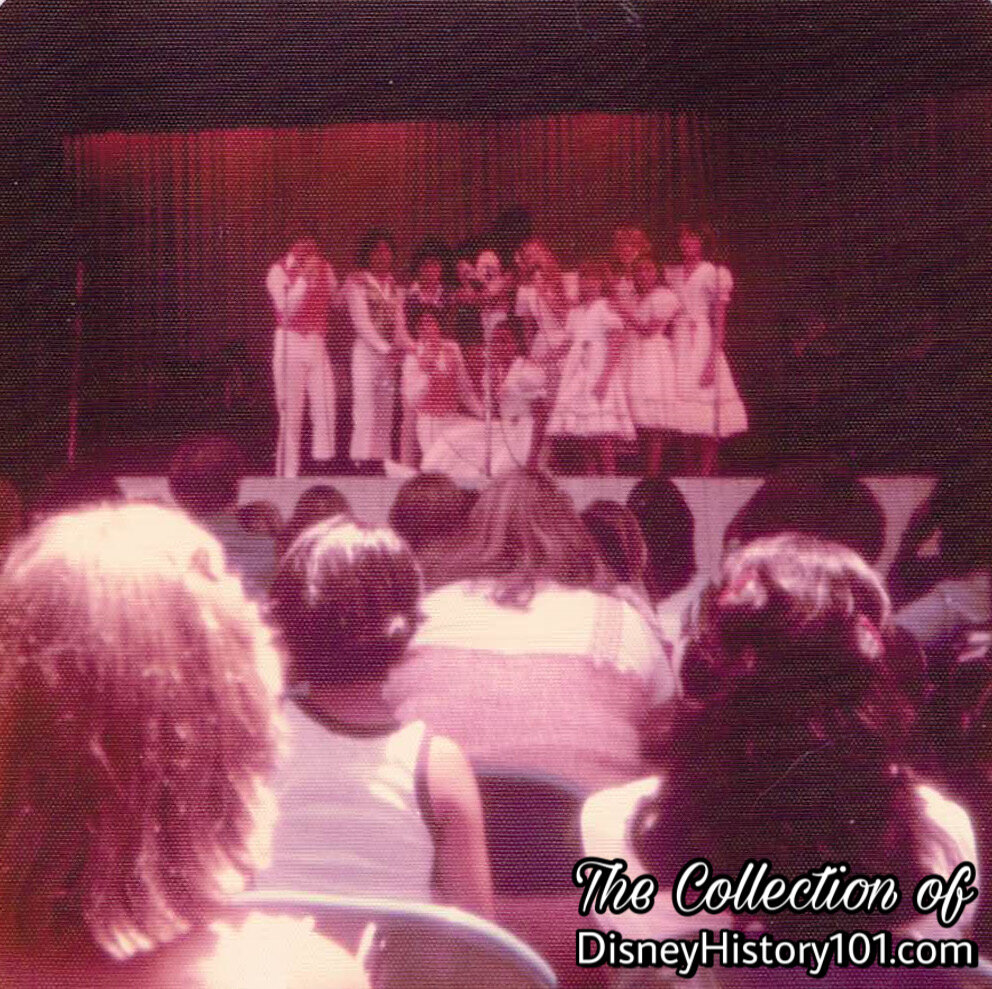
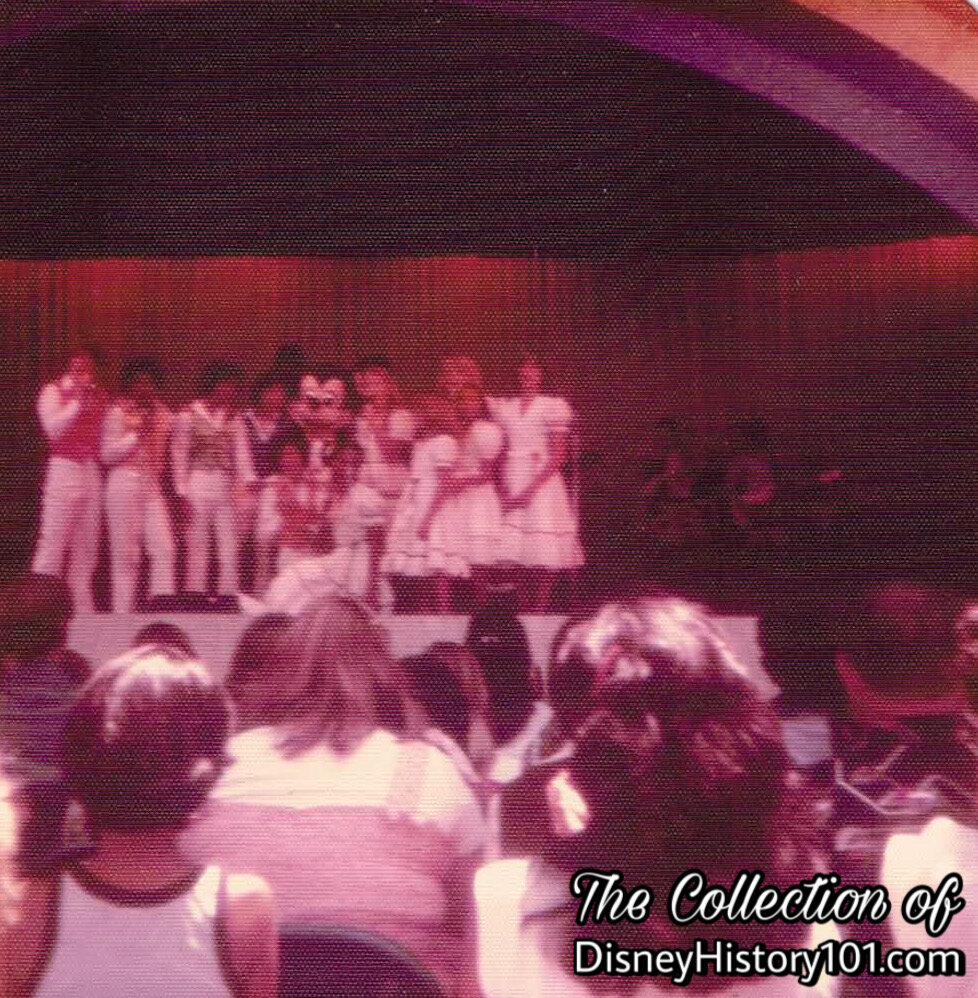
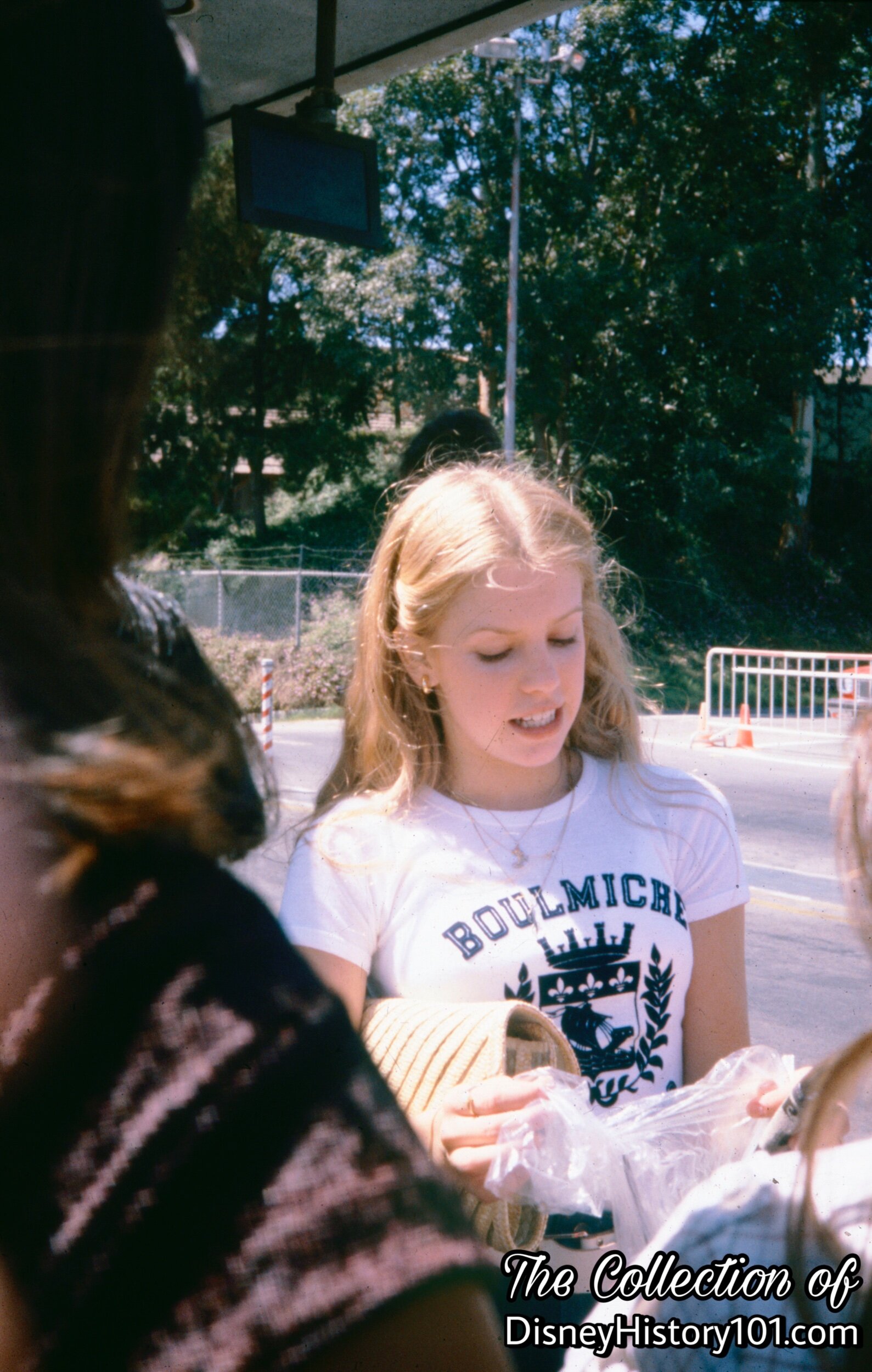
All-New Mickey Mouseketeer Julie Piekarski remembers performing at Disneyland. In interview with Disney History 101 Corespondent, she recalled :
“We performed at Disneyland. We did three shows a day, six days a week for thirteen weeks, and also two parades a day. And I have to tell you, it was amazing! It was not like work.
I was like thirteen or fourteen years old at the time, and who wouldn’t love going to Disneyland everyday? It was awesome! …We were on the ‘Space Mountain Stage’. That’s the one I remember most. We did do one performance during Easter Time and we were by the Small World Stage. But my favorite was when we did the Space Mountain Shows and we were there for almost a whole summer. Whenever there was a break, we got to go and ride Space Mountain (like several times in a row). Then we would go and eat lunch and go back and do a show. That was a really great memory to have, for sure!…
I loved doing the singing and the dancing! We did some Broadway revue shows. And then we did the 60s, the 70s, and the 80s theme show. But a number that I really enjoyed doing was a number called ‘Friends’ which was originally written for our show - the Mickey Mouse Club. We would… sing it, and then we would get to go out into the audience and bring up someone from the audience… That was really cool! We’d get out there. We were always excited, scoping out the audience… who we thought we’d bring up. And what was really amazing and sweet is that we were there for so many weeks in a row that we had a fan base that would keep coming back to every show, every day, throughout the whole summer. We kinda got to know our fans, which I loved and I treasured. That was one of the most memorable experiences - that I would get to go down into the audience, bring up these fans. They looked up to us (and we’re just regular people), but it was so cool to have them up on the stage with us, and we would sing our song ‘Friends’ to them. I really enjoyed doing that.”
Julie also recalled when they filmed the All-New Mickey Mouse Club television show at Disneyland. “Friday was Showtime Day, and it was done at Disneyland. We would have our Honorary Mouseketeers come on at that time. We went to Disneyland for two weeks out, to film all those shows. We got to actually be in the Park when it was closed. We would get there really early in the morning and we’d also film during the day. They would block off our area in Carnation Plaza and then we’d also stay at night when the Park was closed. It was too cool just to be in the Park and nobody else was around. It was so quiet.”
There are several memories that Julie carries with her from this experience. “I got to be in charge of Mickey. Mickey would be in our shows at the end… and I would get to go ‘Off Stage’ and hold his hand and walk him ‘On.’ That was just a really amazing experience to think that I had that honor and that responsibility. The was really neat.”
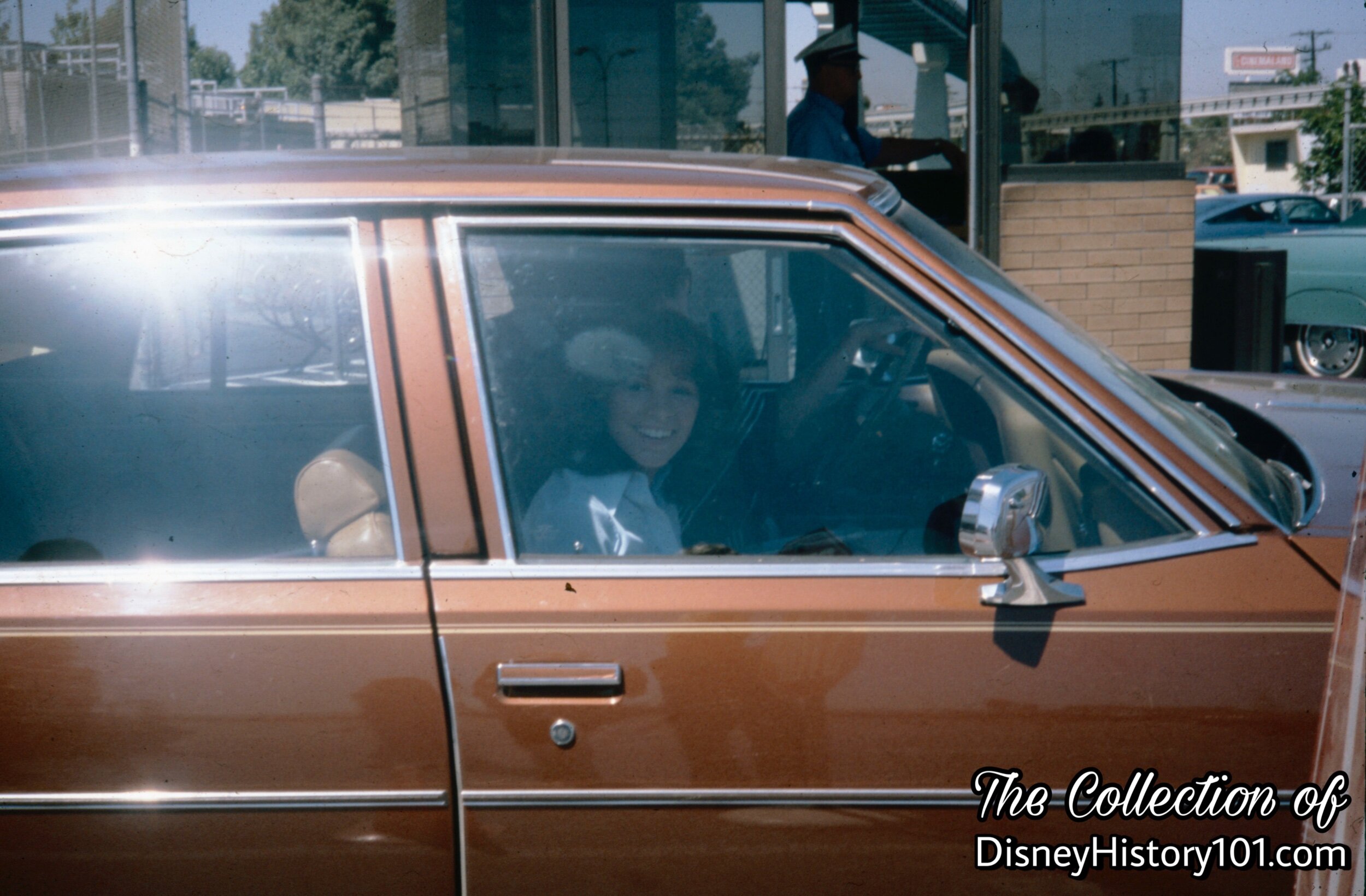
After “The New Mouseketeers Show” (held June 29, 30, and July 1, 1978), Allison Fonte leaves the Park from the Harbor Gate after completing another performance with her co-stars!
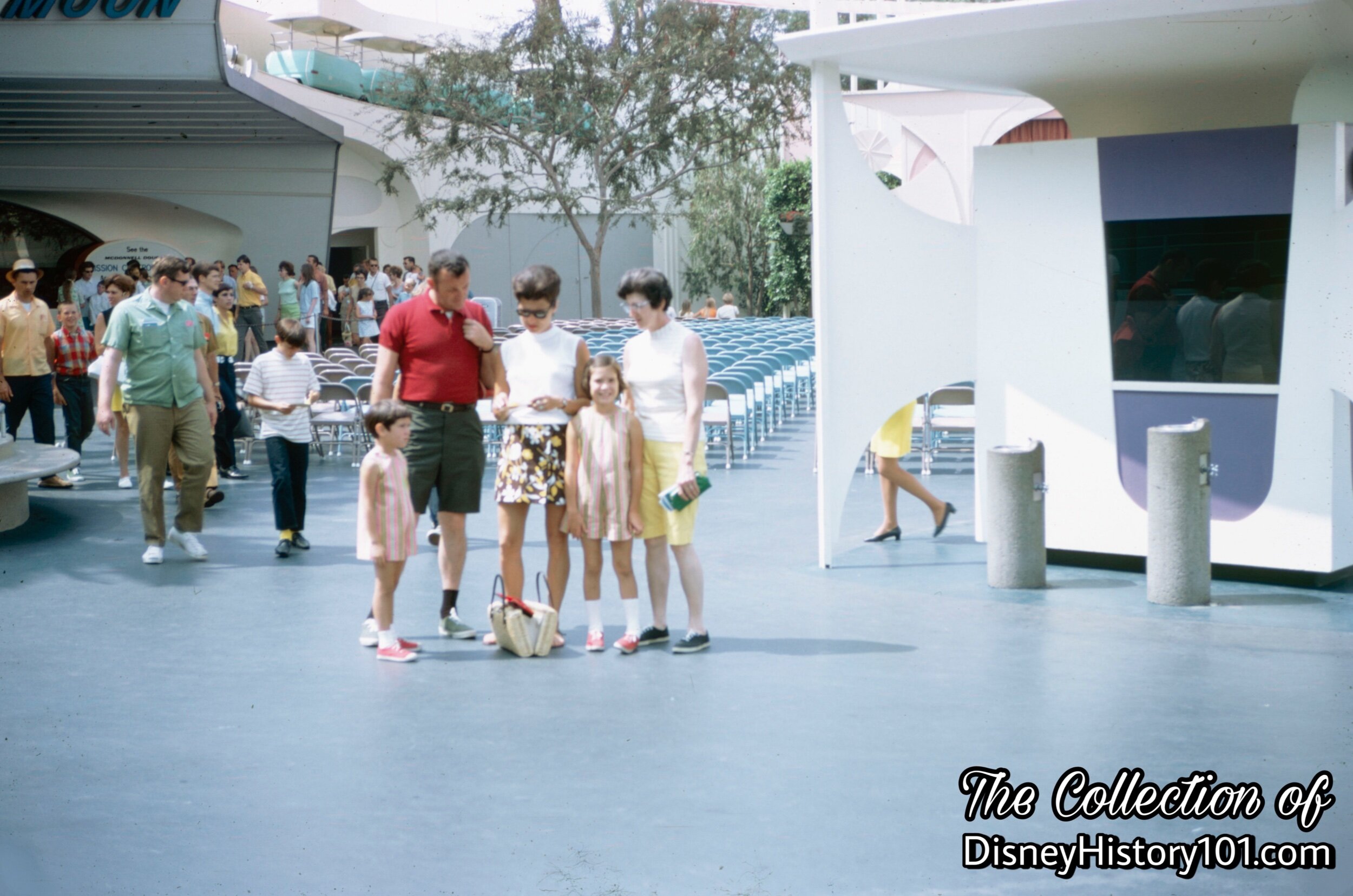
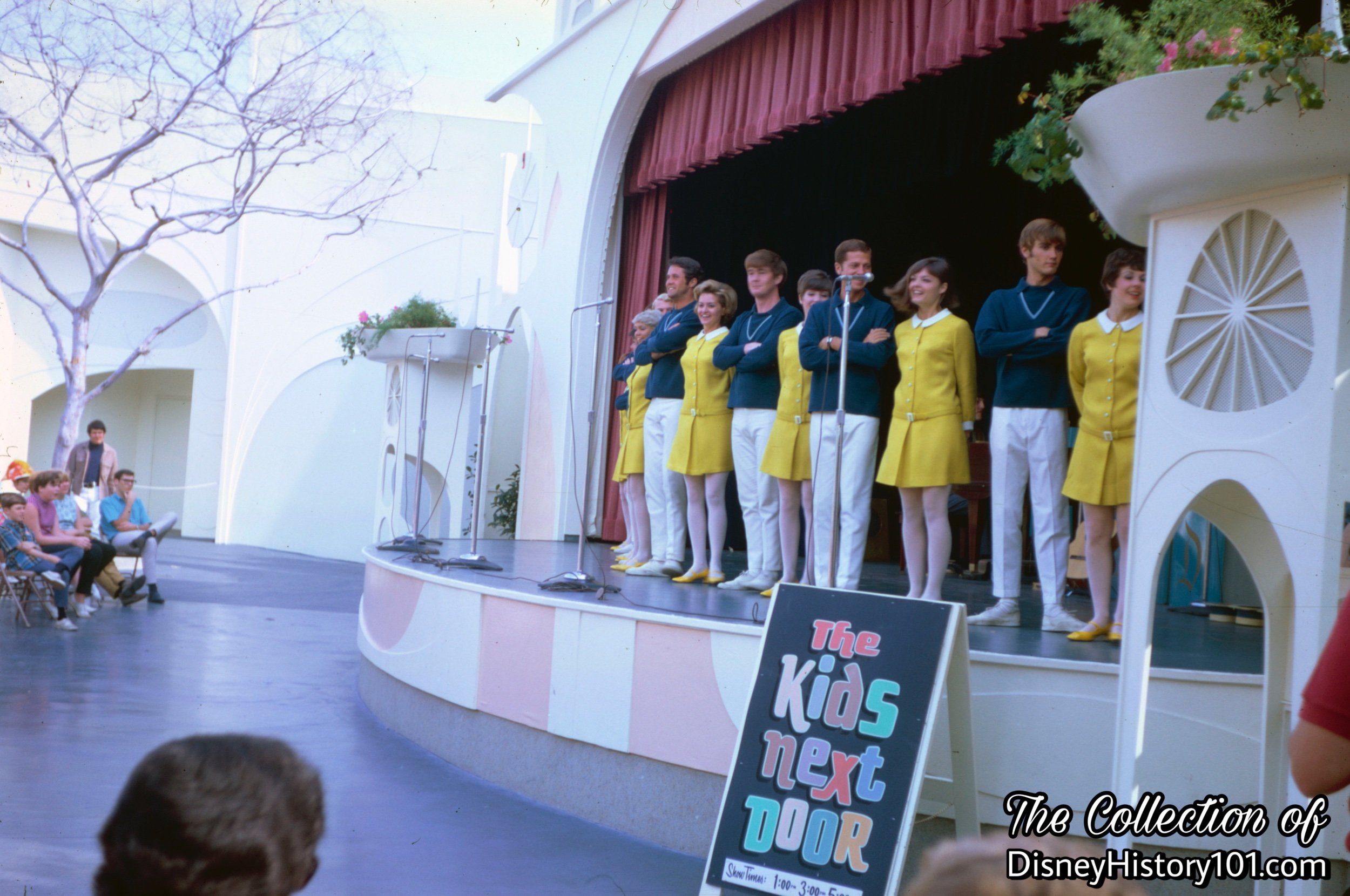
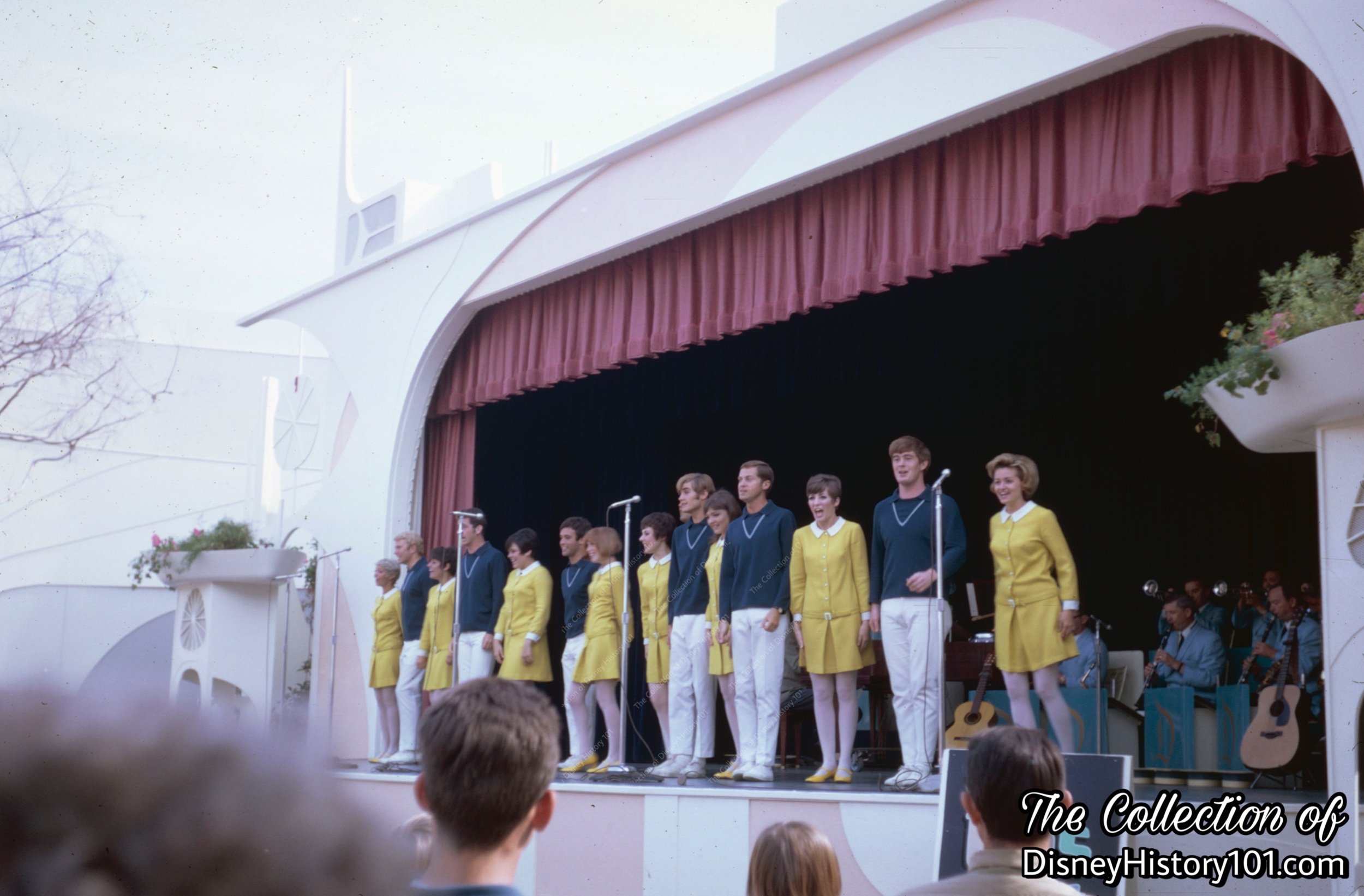
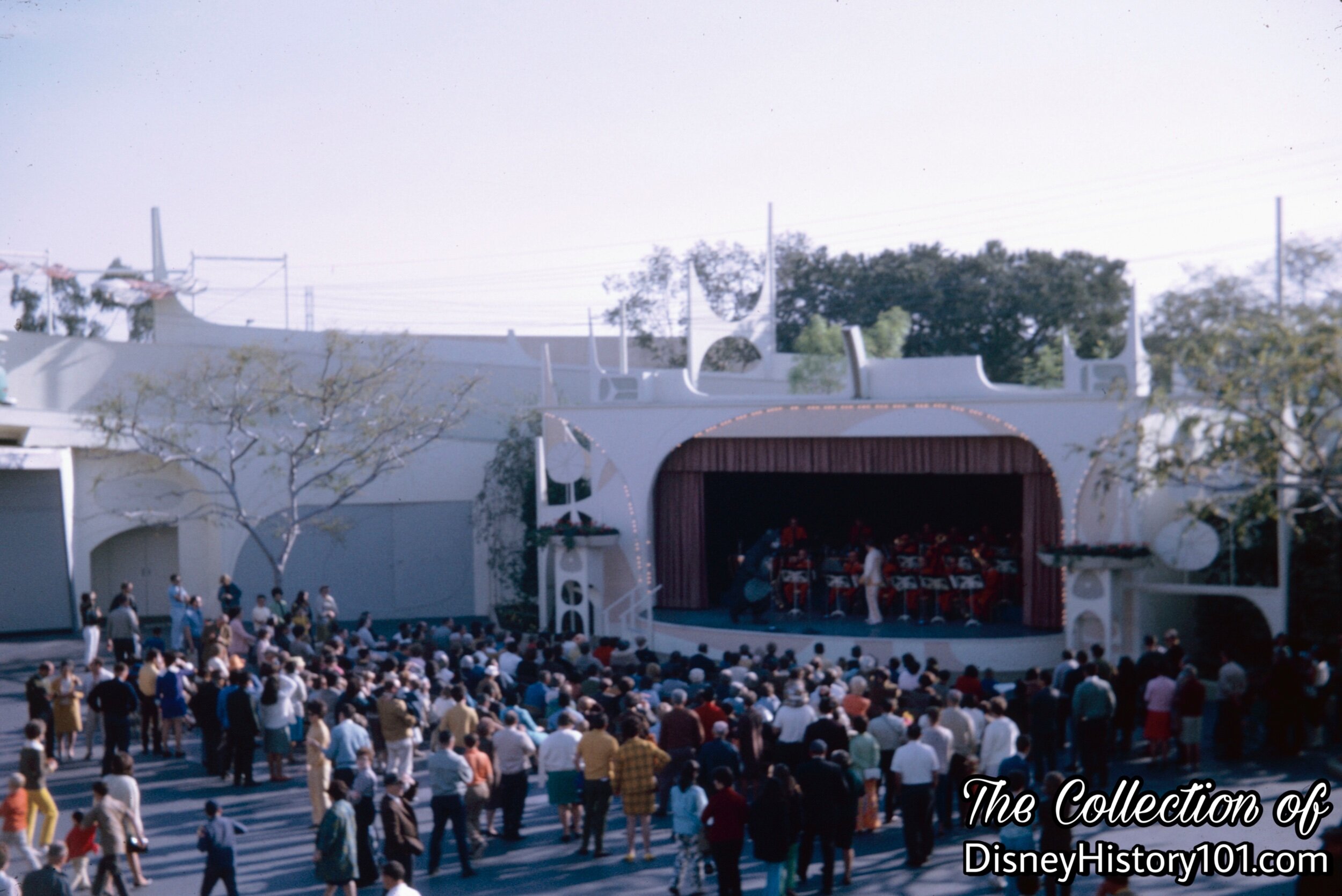
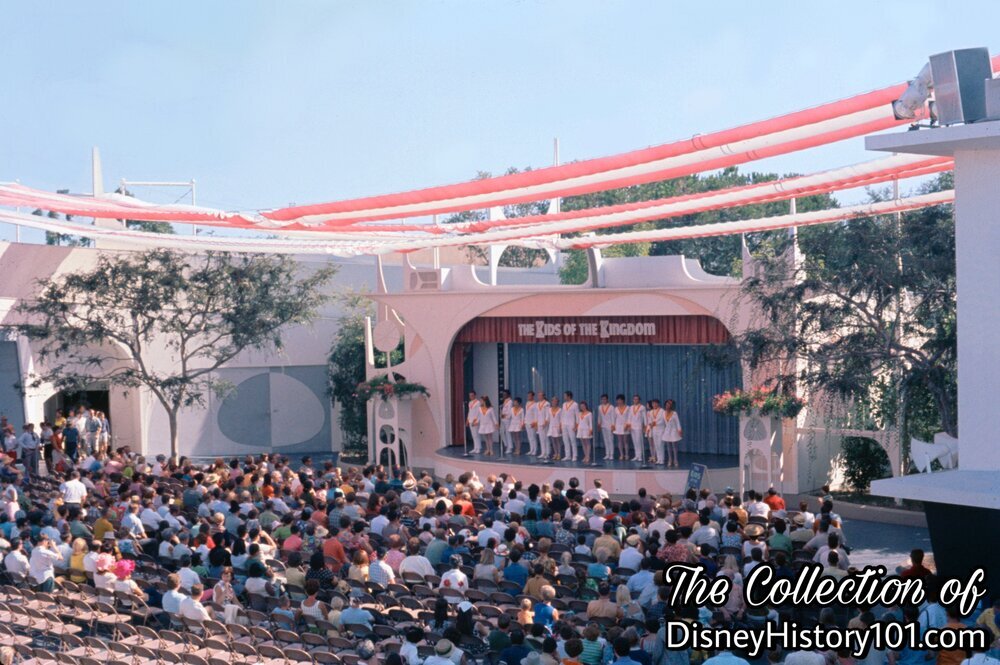
The look of the Space Stage was familiar - blending elements similar to those of the nearby Tomorrowland Terrace! By 1970, “Disneyland Dimensions” reported that ”each year the Maintenance Division places approximately 325,000 chairs in various Park locations for special events, (Chairs are counted as they are placed, then removed for cleaning.)” Many of those concert chairs were placed near the Space Stage.

The Kids of the Kingdom were singers, dancers, and college talent which made numerous daytime performances from the Space Stage during the early 1970s. Back on November 24, 1970, the Kids of the Kingdom performed at an international Bank of America convention in San Francisco. They previewed their new routine that they would perform on New Year’s Day atop Bank of America’s entry into the Tournament of Roses Parade in Pasadena. Among the group was ”Linda Piesik, Rich Briggs, Tom Ranier, Amy Sheridan, Connie Bubar, Jim Eskew, Lady Lee, Gerald Lee, Candy Herzer, Paul Hough, Jim Schick, Sherman Segraves, Kathy McFadden, Vince Pirillo, and Joe Croyle. Also along for the trip were Barnette Ricci, Ron Swartz, and Sonny Anderson, all of Entertainment.” [“Inside Disneyland,” Vol.5, No.1]
They even performed here alongside the Osmonds for a television special! They were part of the 1975 daytime entertainment in Disneyland during the celebration of the American Bicentennial. During the 1980s, the Kids of the Kingdom headed east, and performed in The Magic Kingdom, and they even performed at Tokyo Disneyland after the Park opened on April 15, 1983.
“Brochures were sent to junior colleges and universities across America detailing the unique workshop offered on the Disneyland and Disney World ‘campus,’” according to Disneyland LINE (published August 6, 1975).
According to the same Disneyland LINE article, that same year (of 1975), there were “700 inquiries for additional information, some 400 video-tape auditions…received for consideration, This method of selection resulted in 93 musicians who will perform on both Disney stages for 10 weeks, yielding the above unorthodox equation.
The taped auditions were viewed and judged by Larry Billman, Barnette Ricci and Gerry Schroeder who selected Disneyland’s Kids of the Kingdom. Besides the Kids - 6 males & 6 females - an additional 8 musicians were selected for the stage band ; trombone, electric bass, 2 trumpets, guitar, piano, traps and a saxophone player who doubles on the flutes and clarinet. This composition is duplicated at Walt Disney World, resulting in a similar company.
Choreographed by Barnette, the show emphasizes our Bicentennial Sumer of ‘75 and begins when Tony Moore runs on-stage and proclaims ‘…And for the next 20 minutes we’re going to show you why we love America!’
The Kids for 1975 arrived June 15 for orientation. In the morning they were introduced to Ron Swartz, Director of Operations in Entertainment, and were briefed on the summer’s expectations for Disneyland’s Kids of the Kingdom. Beginning 10 days of intensive rehearsals, they worked under the able direction of Gerry Schroeder from Golden West College, Larry Boye from Ball State, Indiana who leads the vocal group in Florida.”
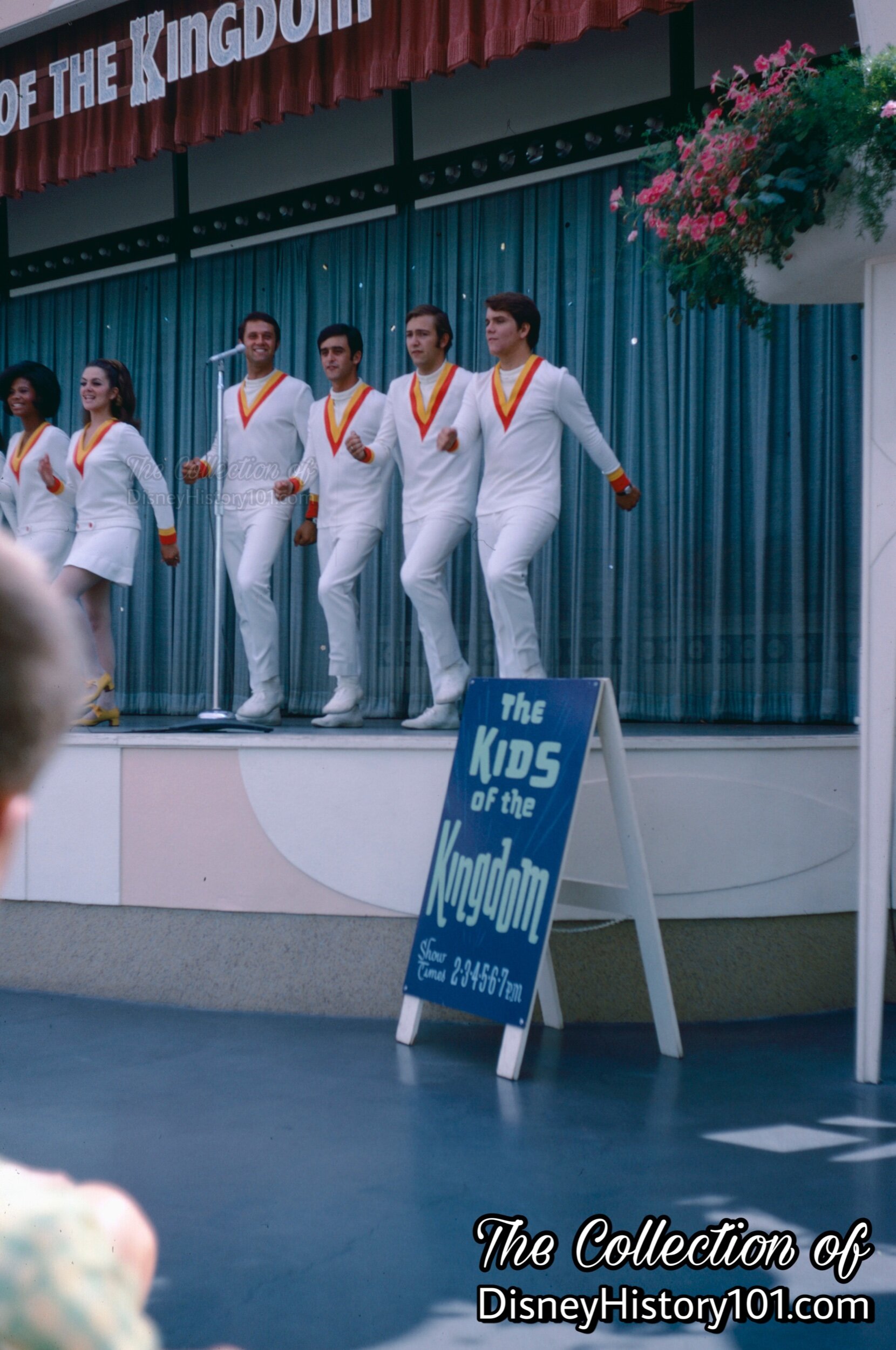
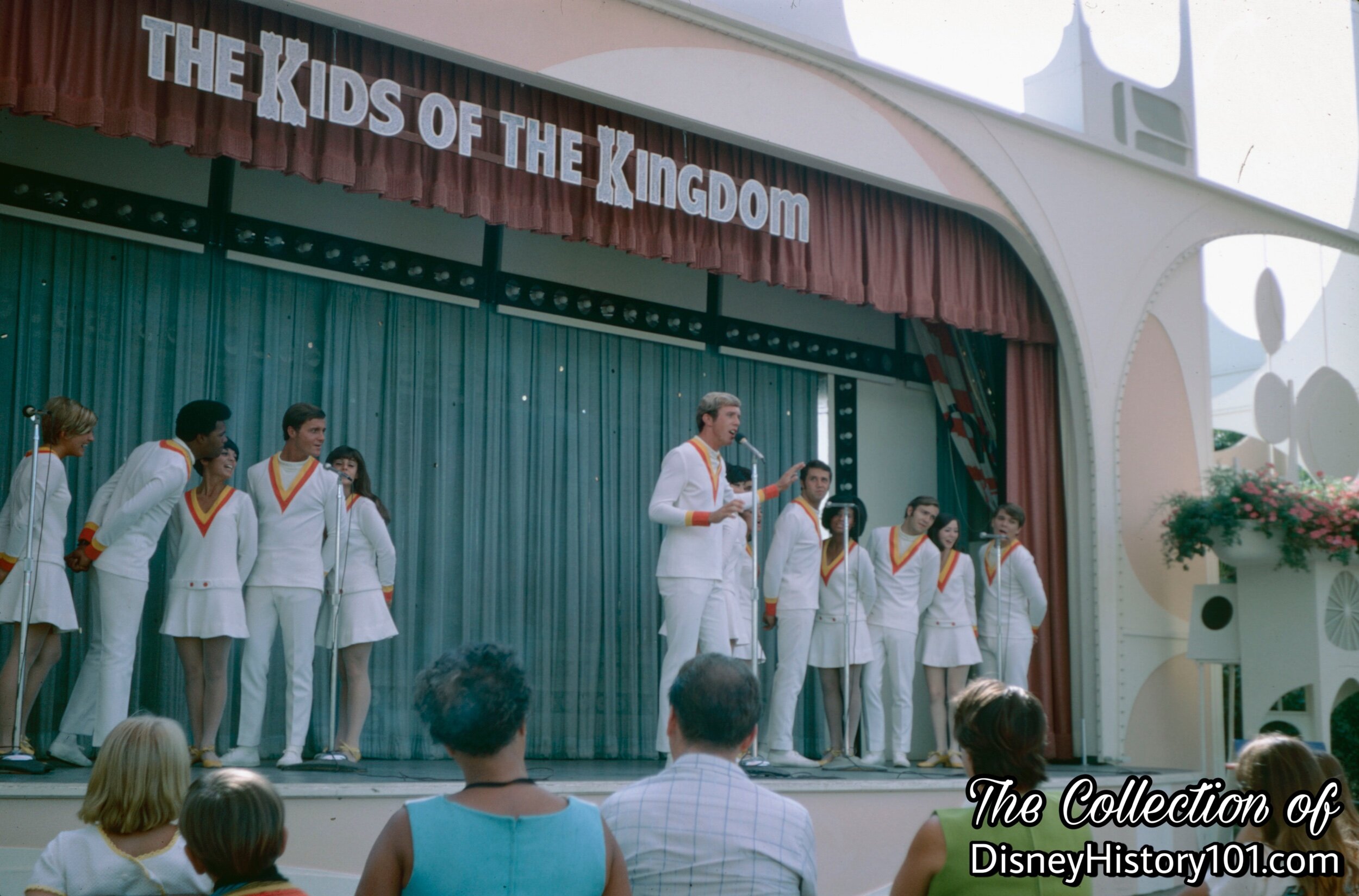
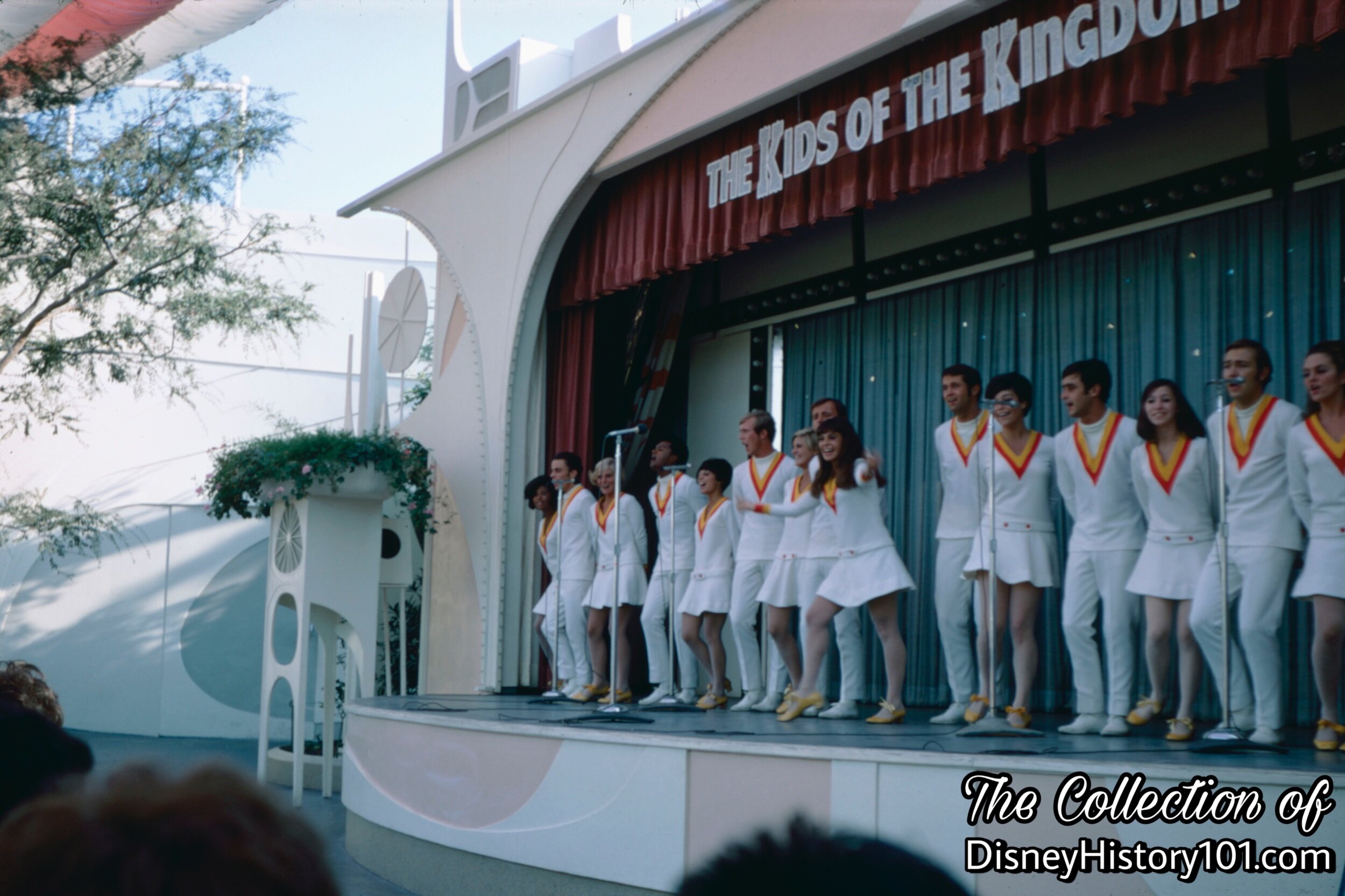

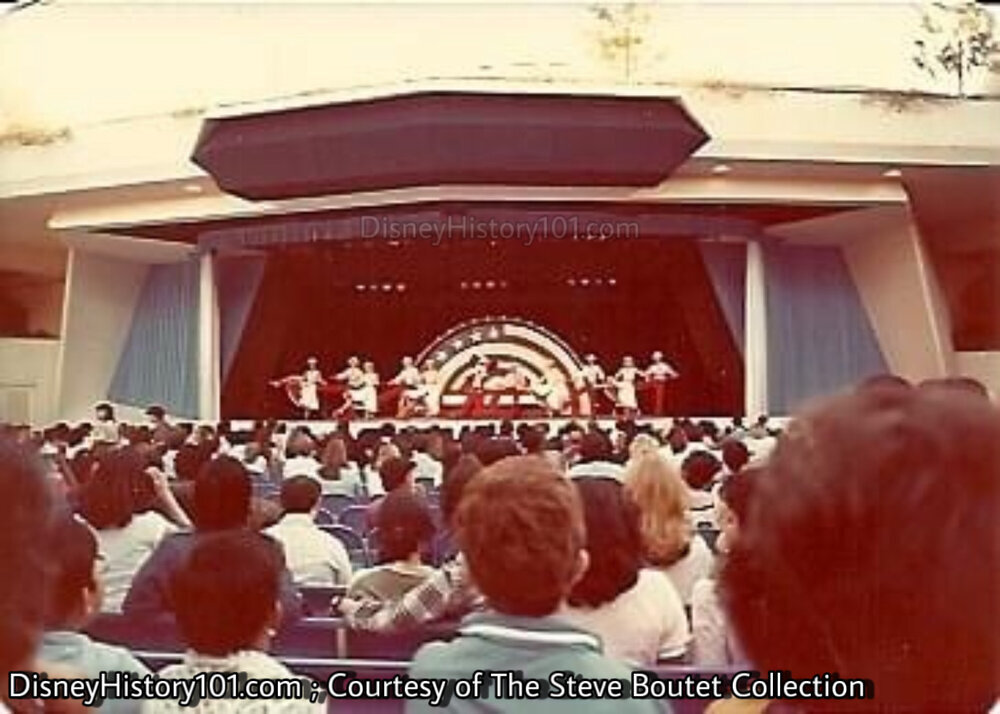
The Kids of the Kingdom performed from the Space Stage on April 15th, 1979, Easter Sunday. Steve (who was a guest that day) recollects : “I was a senior in high school and my parents decided we needed to take one last trip together before I went off to college. We flew from Maine to LA, to visit Southern California for three nights. We did Disneyland [on] the 15th which was Easter Sunday. We made sure to cover the attractions that didn’t exist in the Magic Kingdom…[This] was a country music segment, although I don’t remember if there was any Country Bear Jamboree music. For some reason, I remember hearing ‘Comin’ Around the Mountain’.”
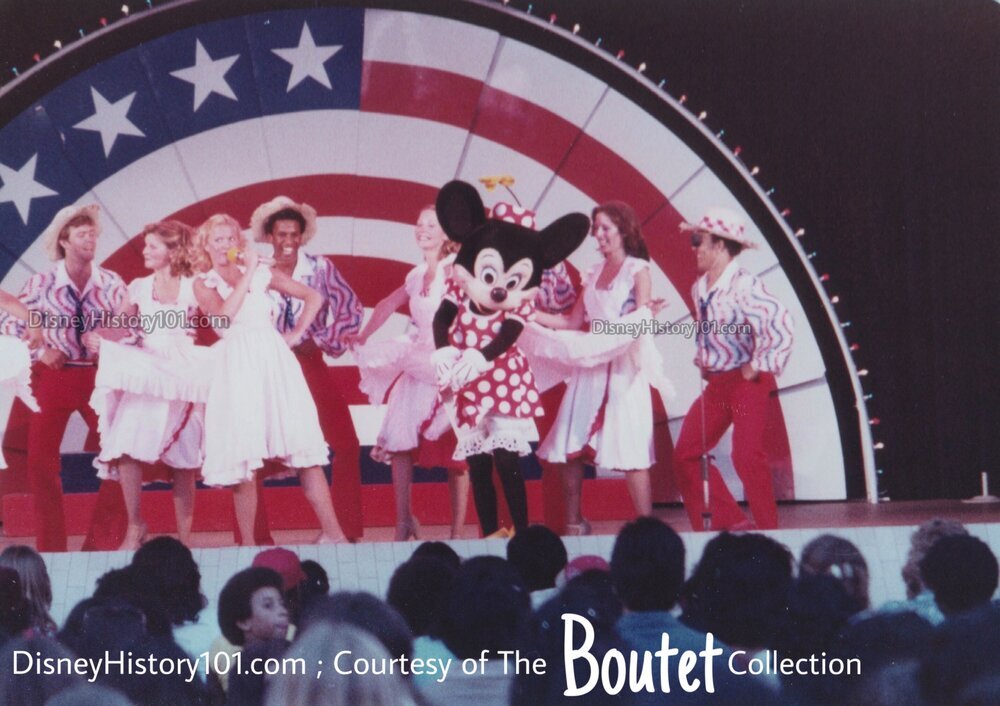
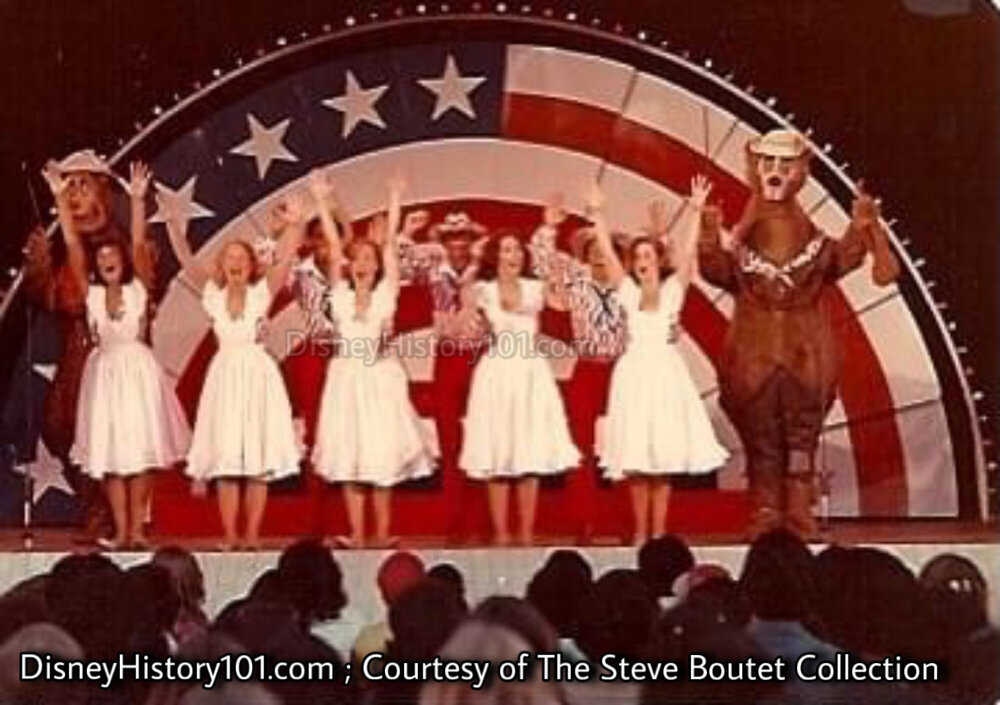
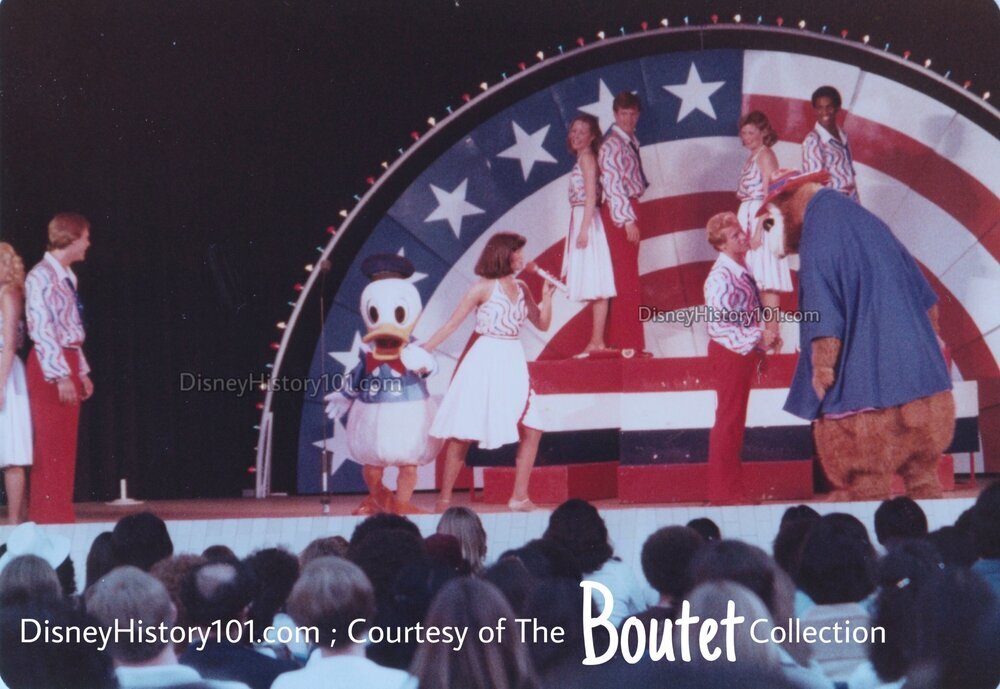

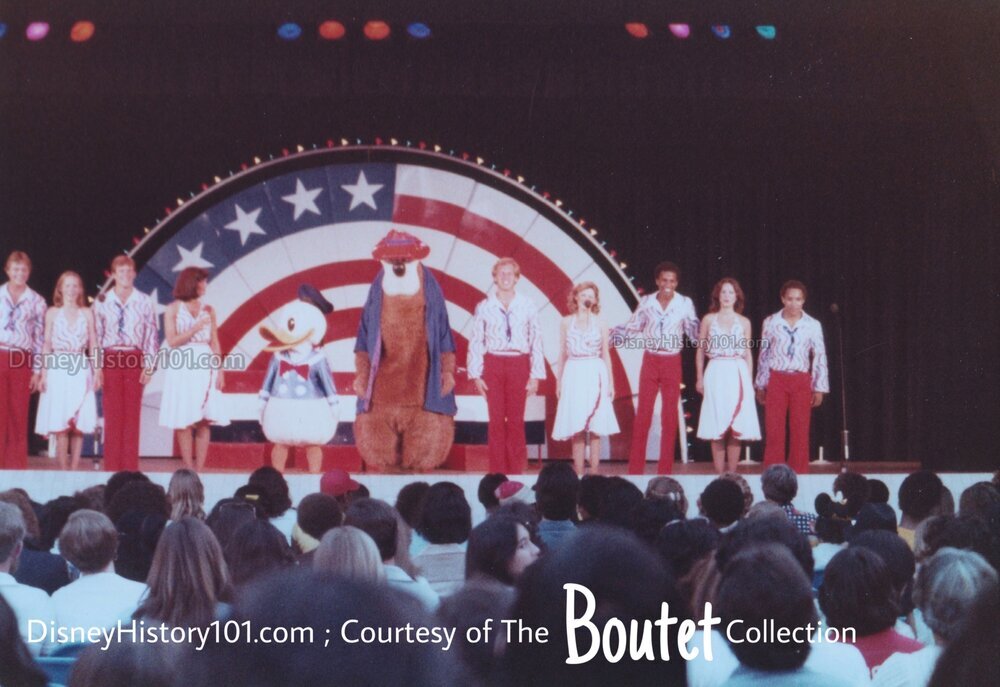
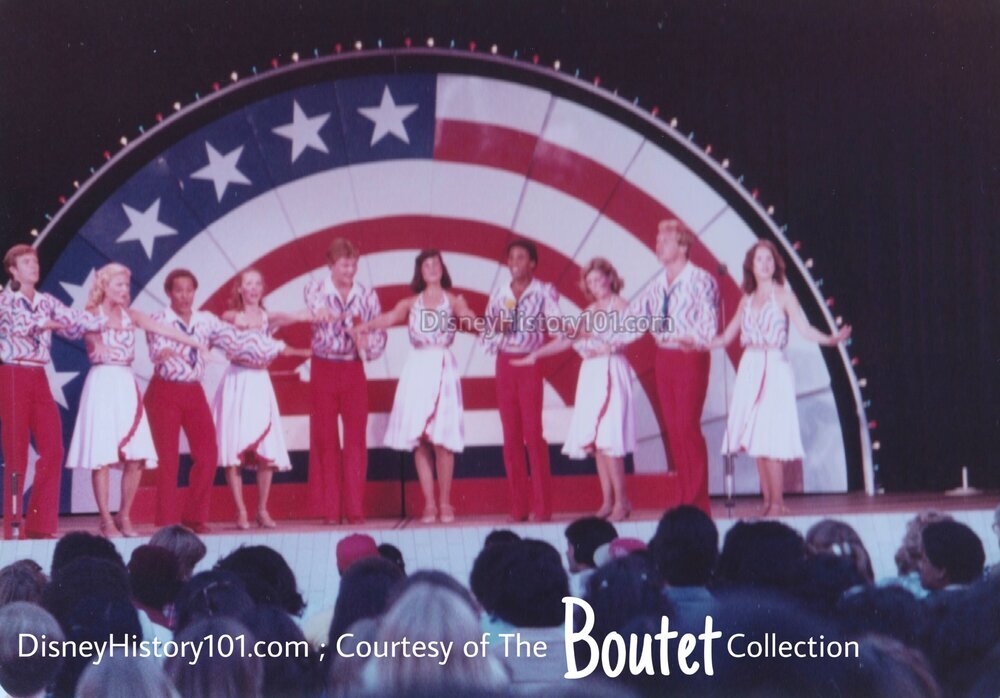
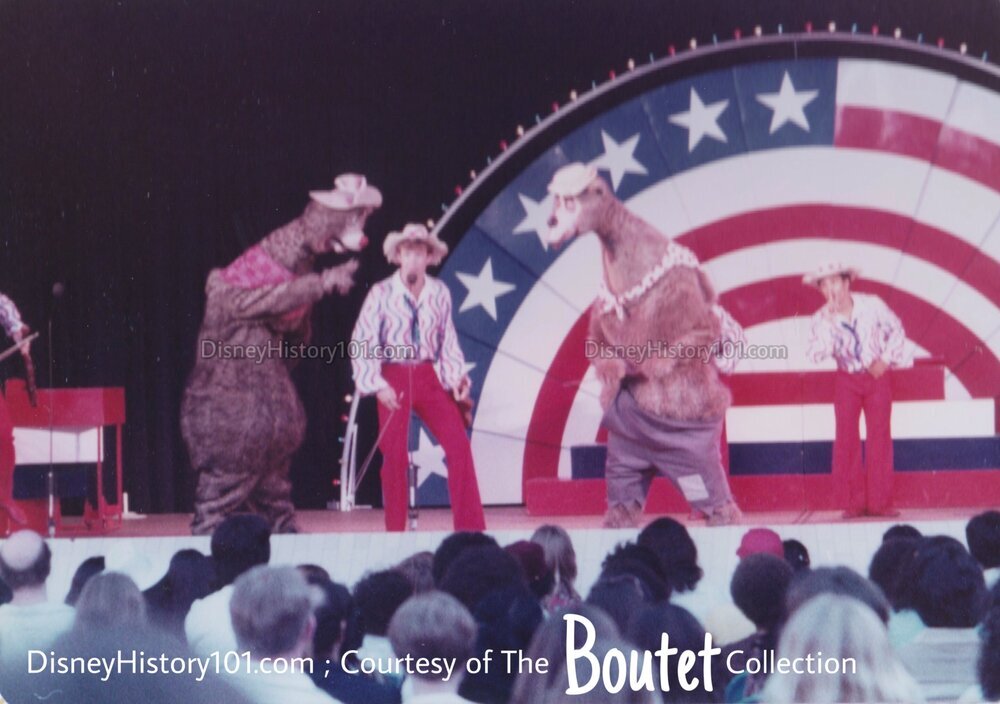
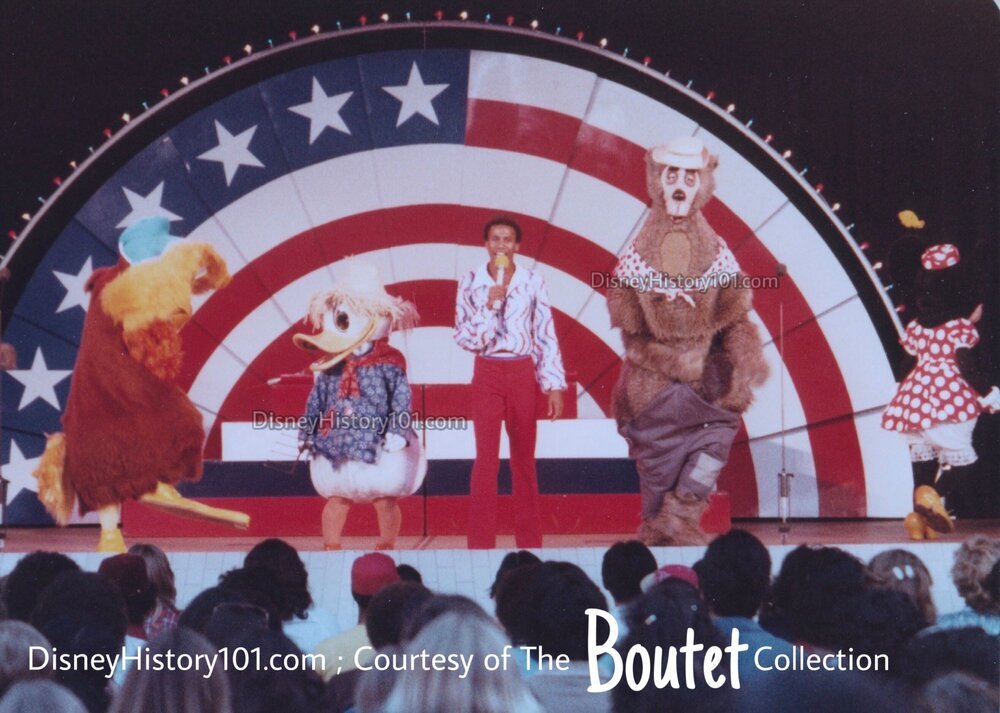
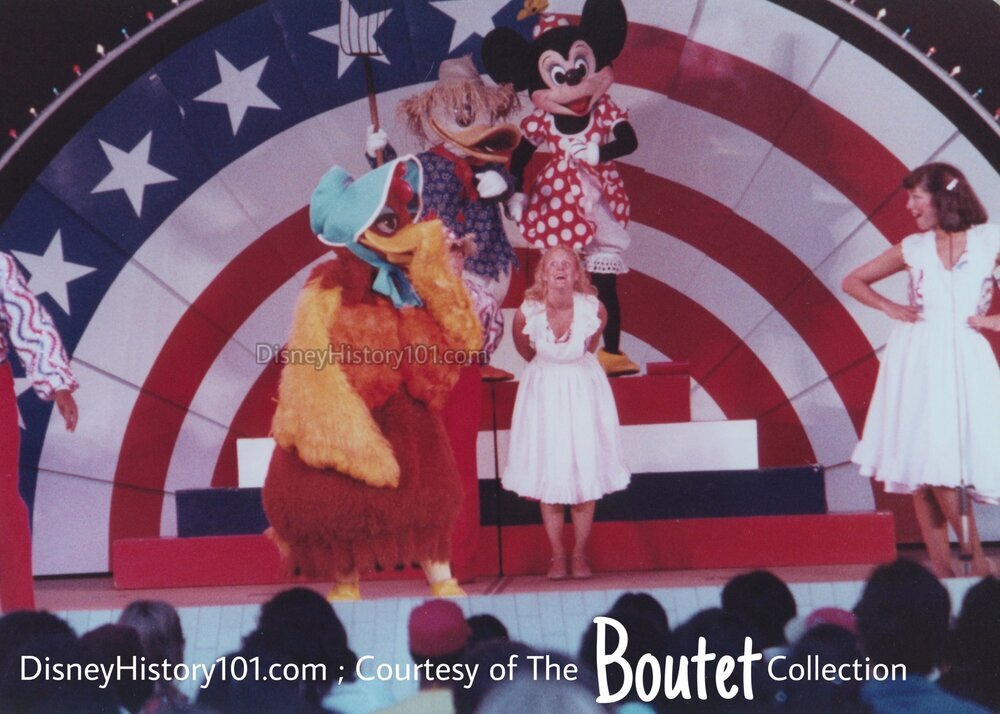
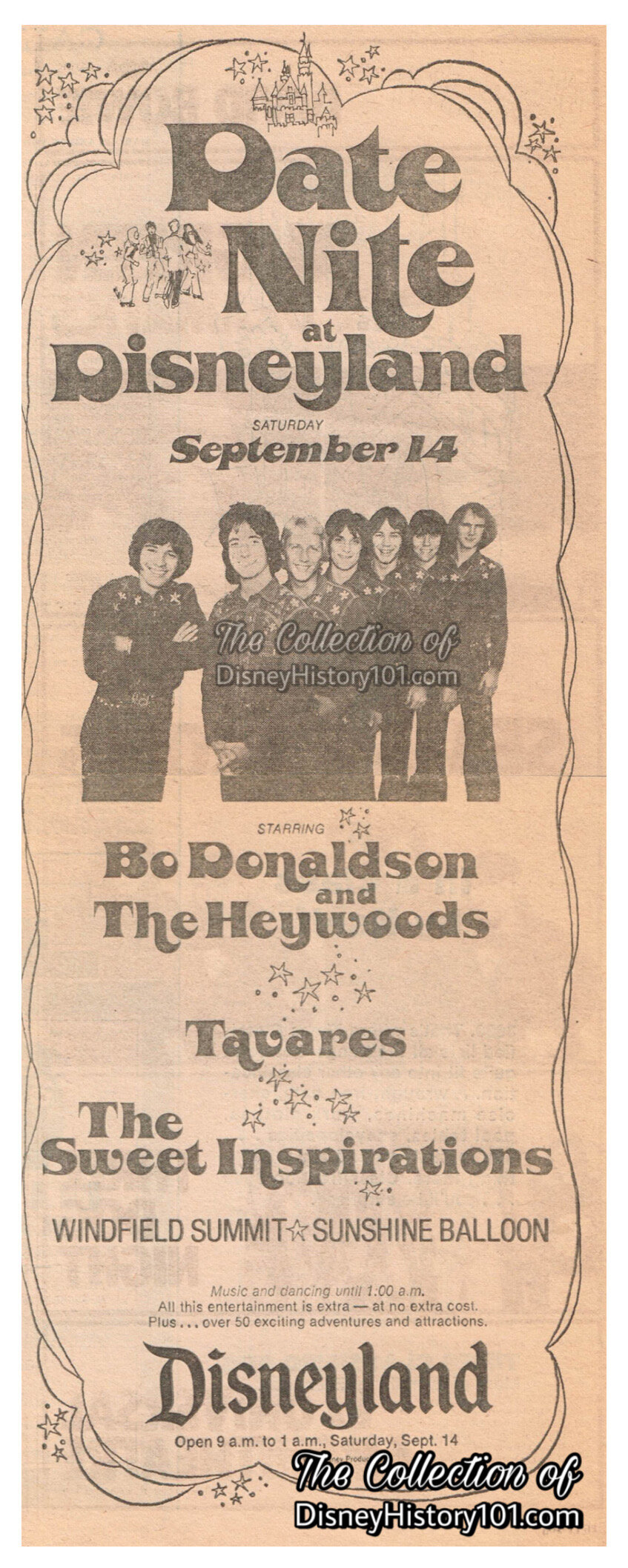
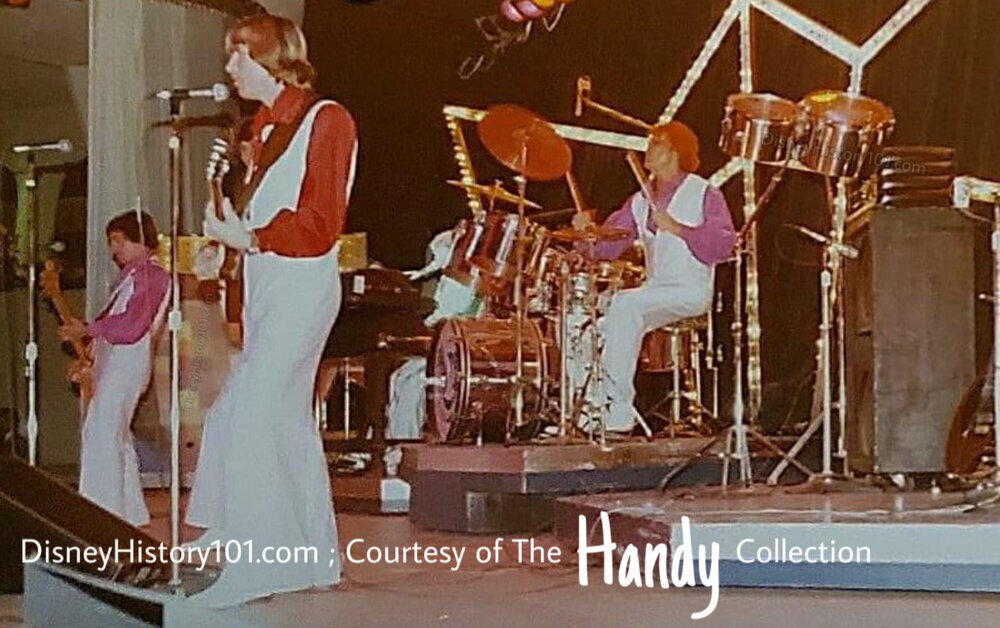
Papa Doo Run Run was also known as Disneyland’s “celebrity house band” (like so many others) for its regular performances from the Space Stage in Tomorrowland!
According to the recollections of others, many others appeared from the Space Stage and the Tomorrowland Stage. Among these talented entertainers may have been the Raspberries, Jan and Dean (and Brian Wilson for two songs, early 70s), Kids of the Kingdom, Tony Orlando, Paul Revere and the Raiders, the Spinners, Maynard Ferguson, Peaches and Herb, Sparks, the King’s Sisters, the Lennon Sisters, the Smothers Brothers, the King Family, Jackson Brown, Pat Boone, Kenny Rogers, Linda Ronstadt, Stone Ponies, Barrage, the Osmonds, Ricky Nelson, the Stone Canyon Band, Tommy Tutone (1982), Pointer Sisters, Manhattan Transfer, KC and the Sunshine Band, Don Ellis, Baja Marimba Band, Association, Hermans Hermits, the Grassroots, the Cowsills, the Jackson Five, Peggy Lee, New Edition, Pete Fountain, the Association, Frankie Avalon, Kurt Russell, Annette Funicello, Ricky Nelson and the Stone Canyon Band, Tina and the Mustangs, Temptations, Carpenters, The Safaris, The supremes , Leslie uggums , Super Tramp, Olivia Newton John, The Monkees, Roy Acuff, The New Mickey Mouse Club, Gary Lewis and the Playboys were there for months, Wild Cherry, Martha and the Vandellas, 3 Dog Night, First Edition, Bo Donaldson and the Heywoods, Bobby Sherman, Sister Sledge, 4 Tops, Al Greene, Gary Puckett, Defranco Family, Main Ingredient, Doc Severinson and the now generation brass, Commodores, George Straight, Debbie Reynolds, Union Gap, Banana Splits, Righteous Sisters, and many, many more!
Stay tuned for more, as we continue to verify the visiting performances and revise the previous chronicling of popular names.
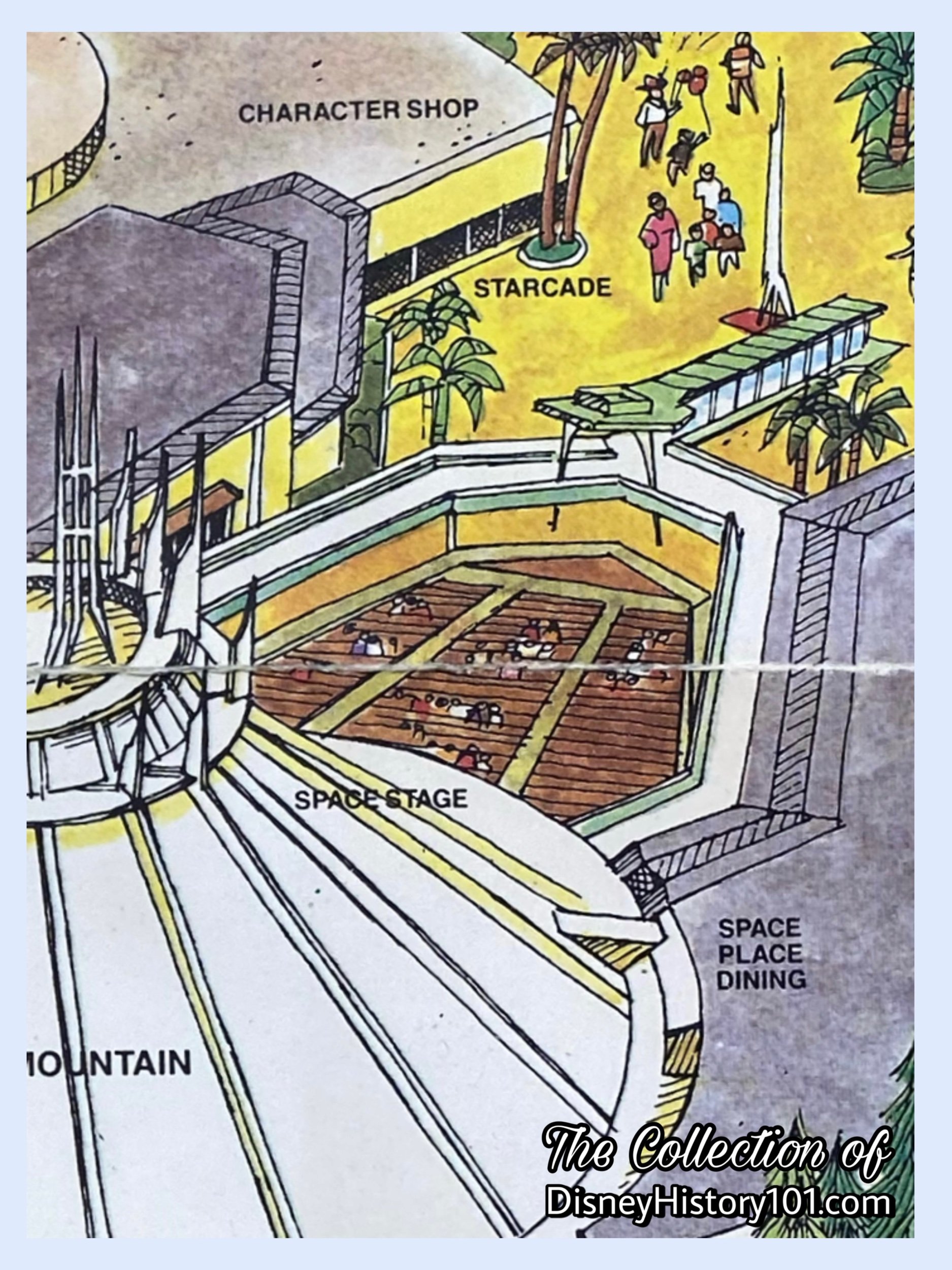
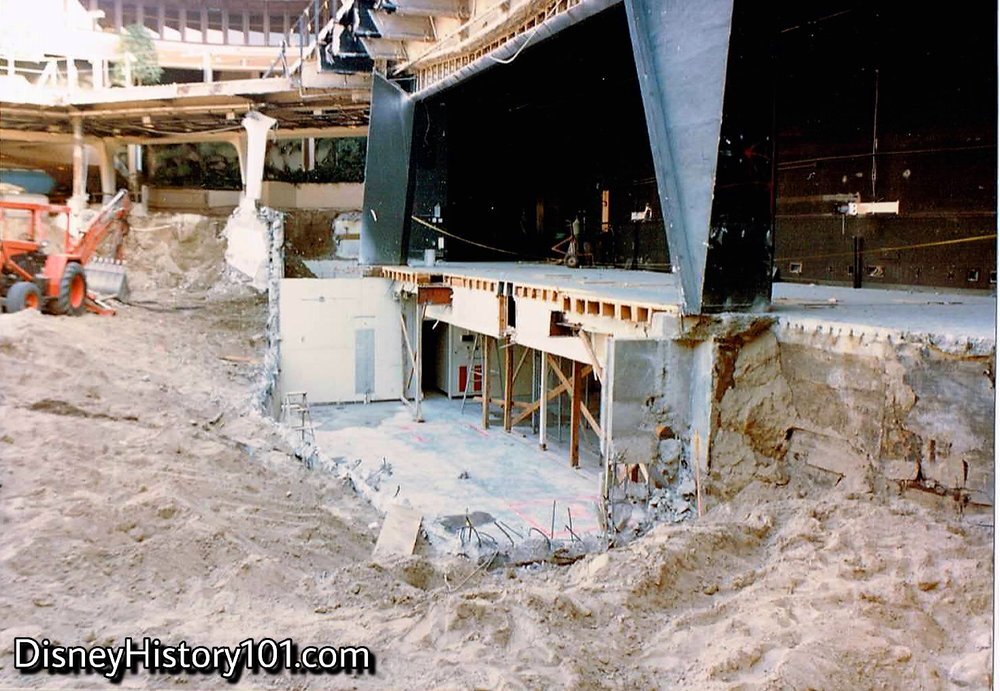
In 1985, the demolition of the Space Stage made way for another futuristic theatrical attraction! These rarely-seen Vintage Views offer a glance of the subterranean hall below the stage.
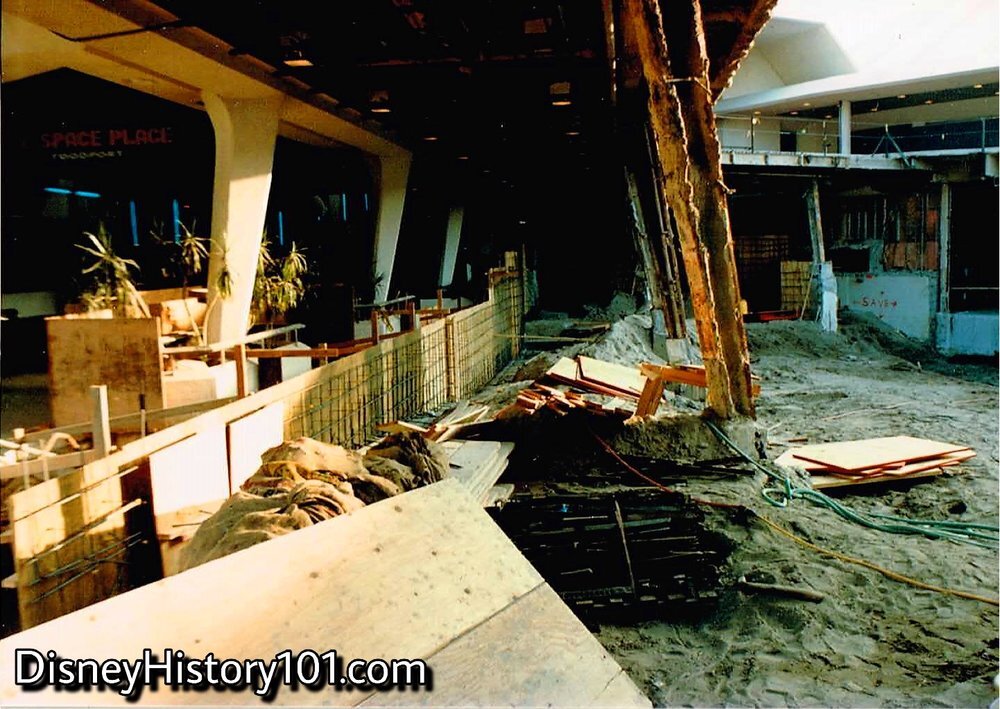

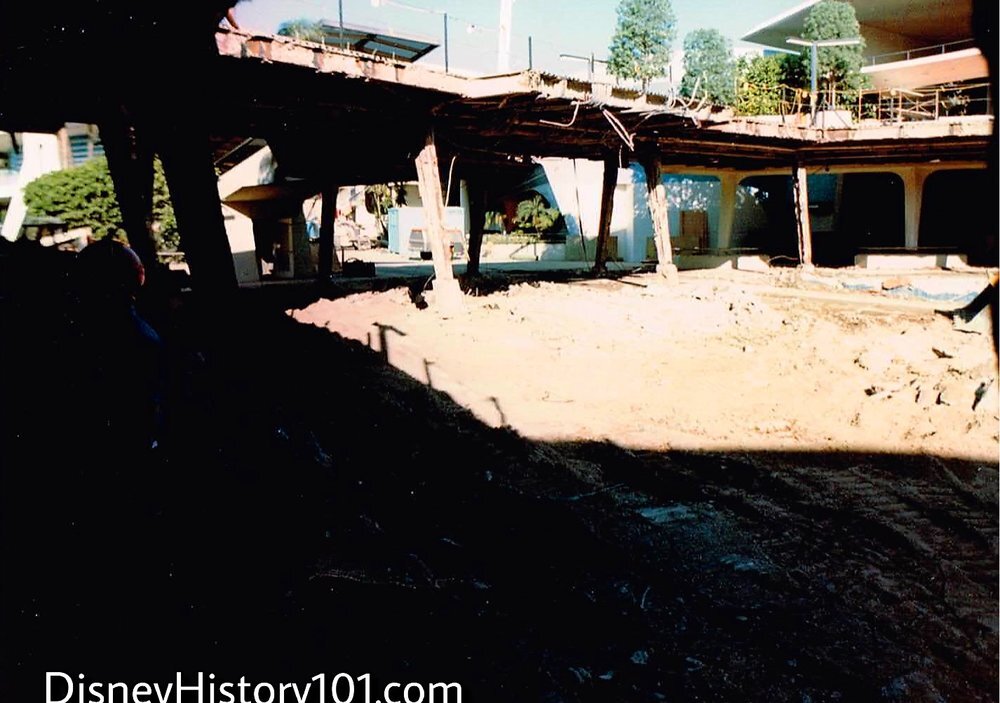
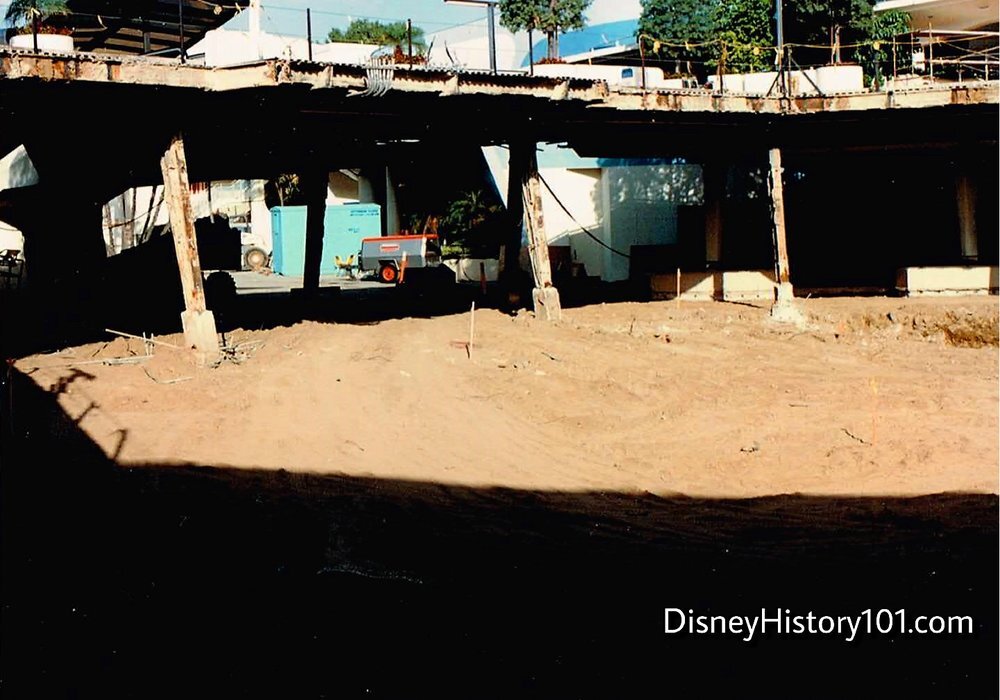
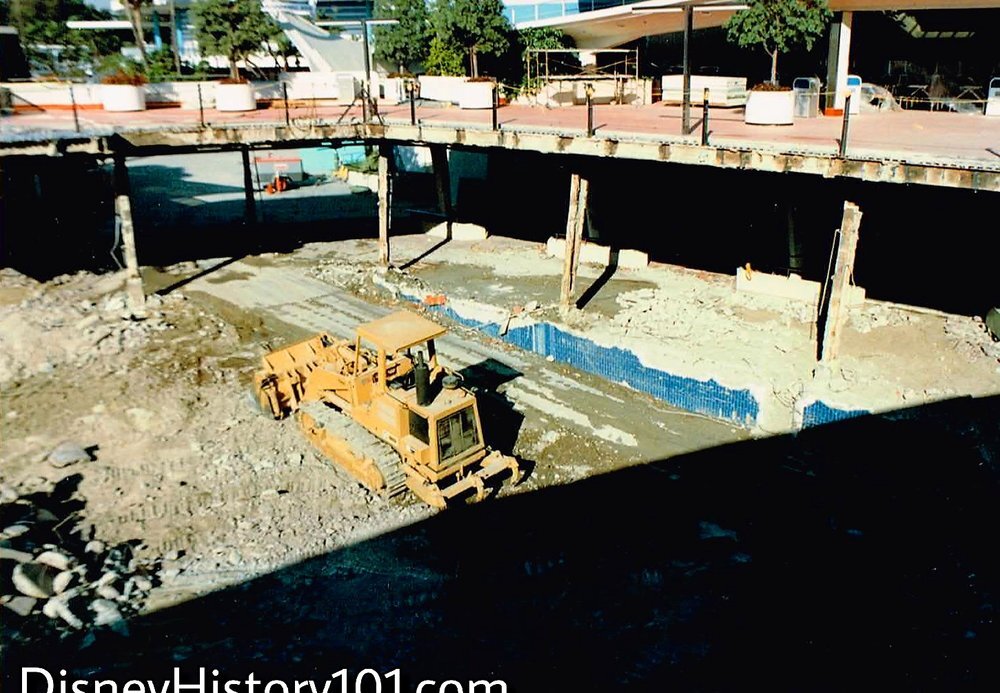
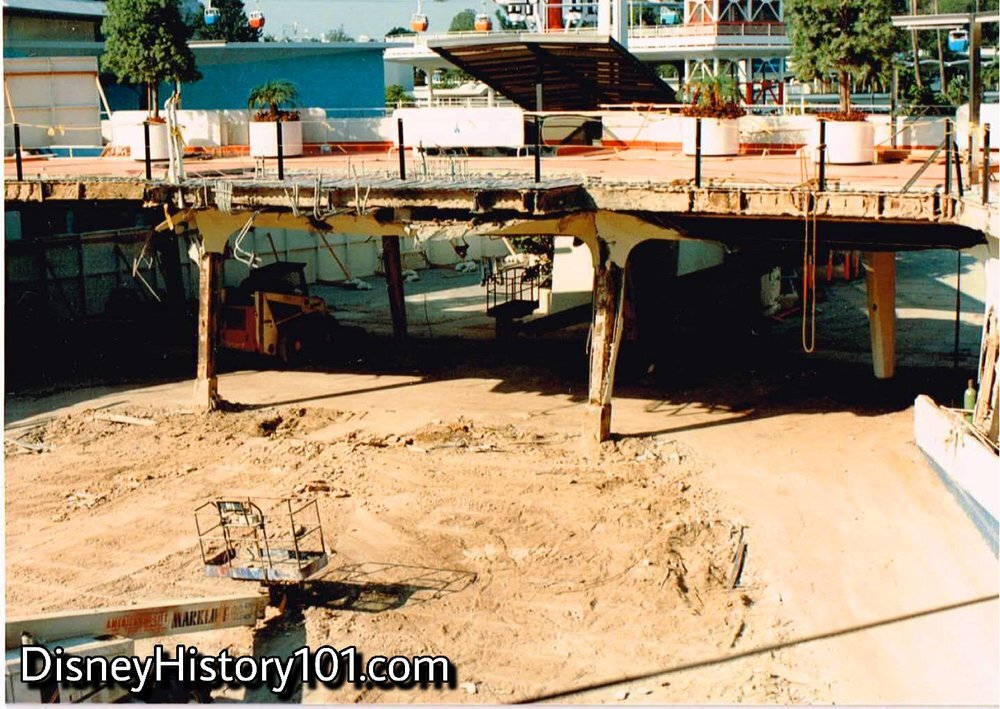
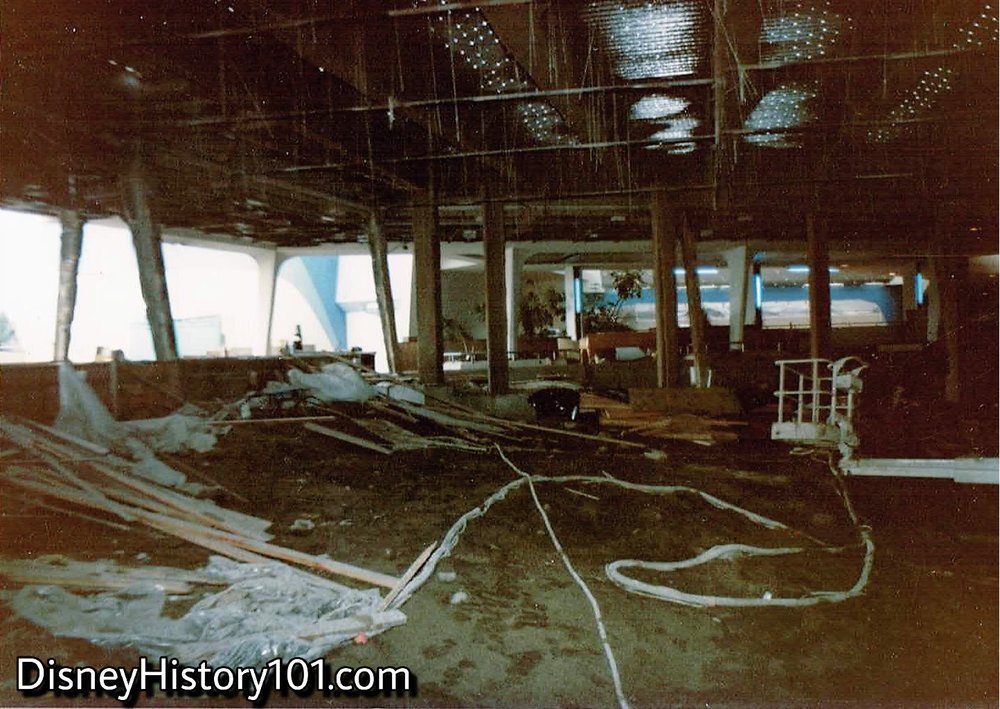
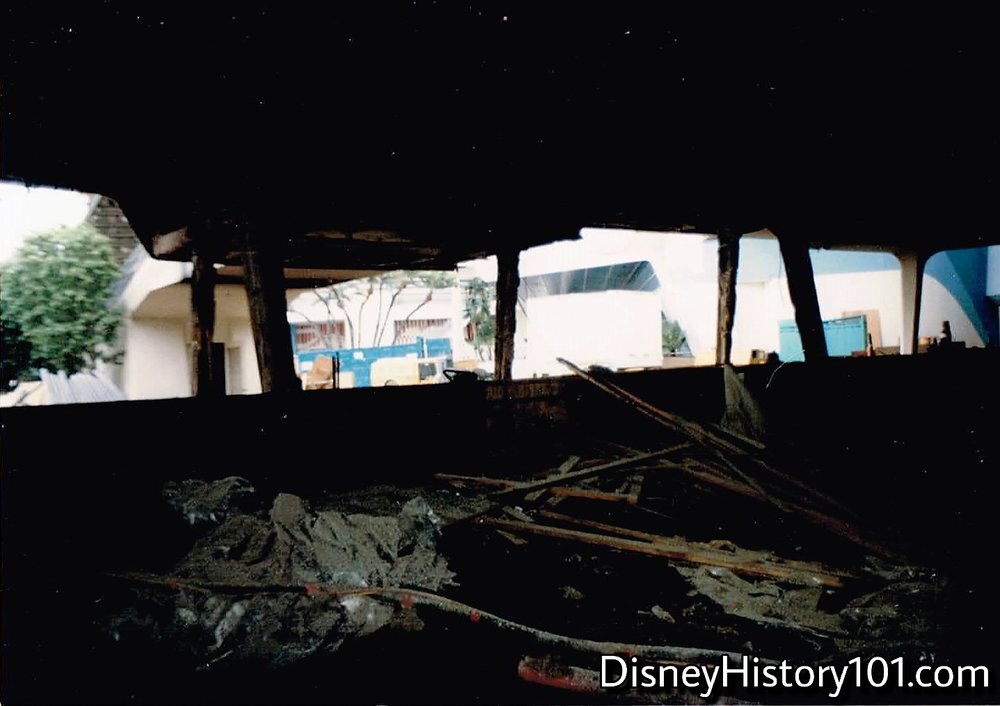
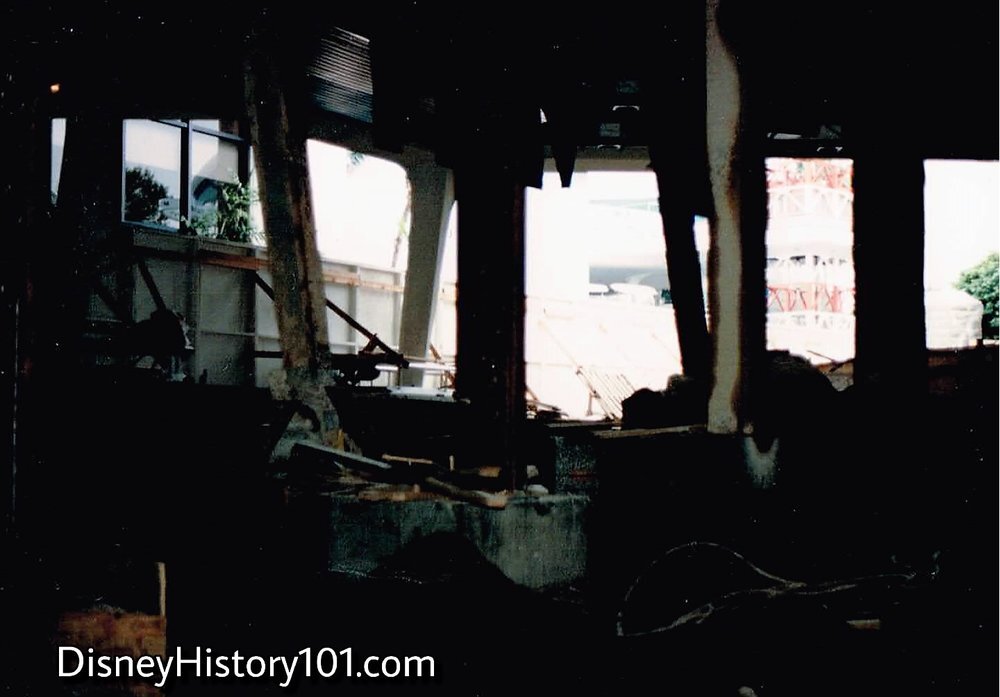
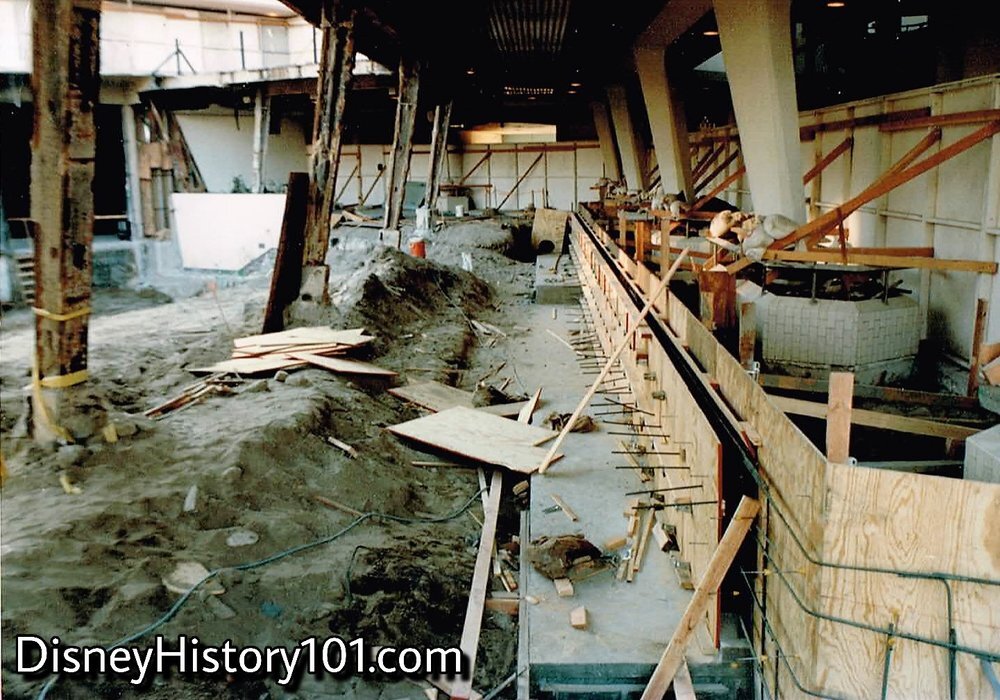
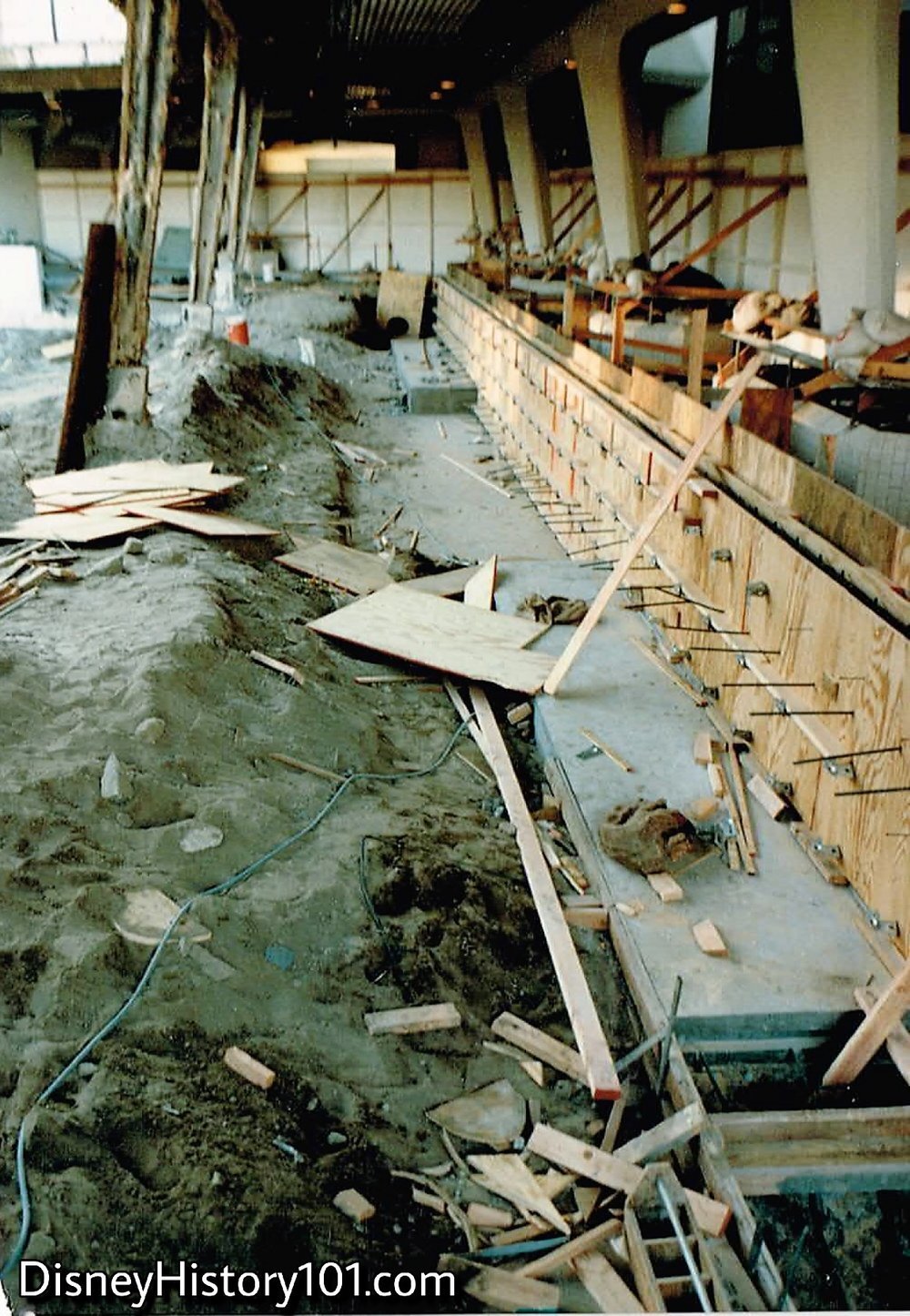
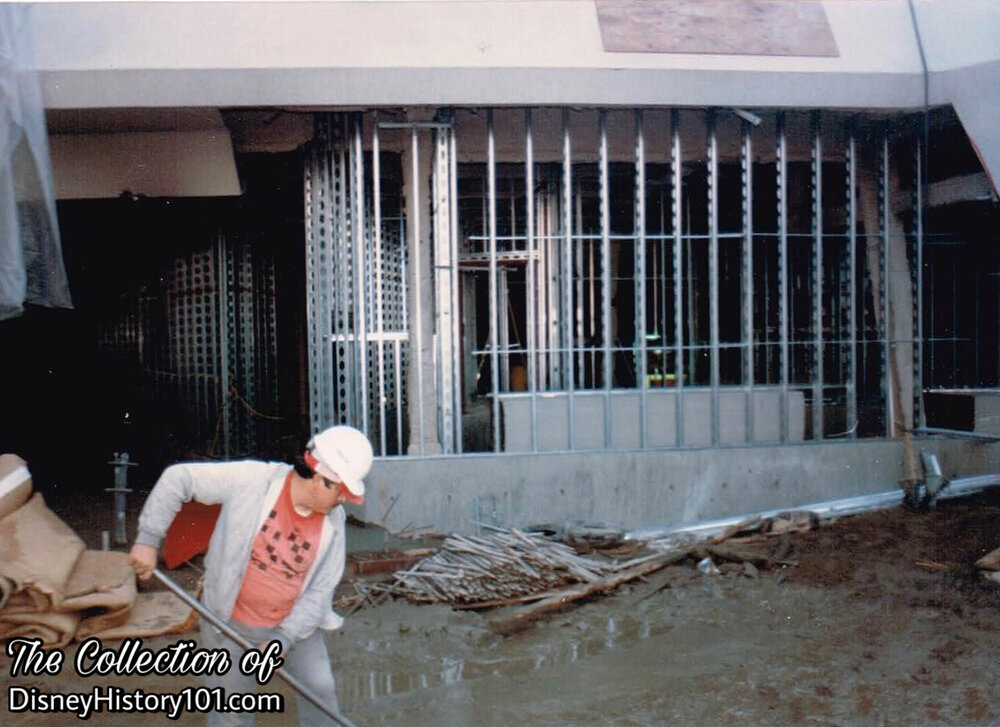
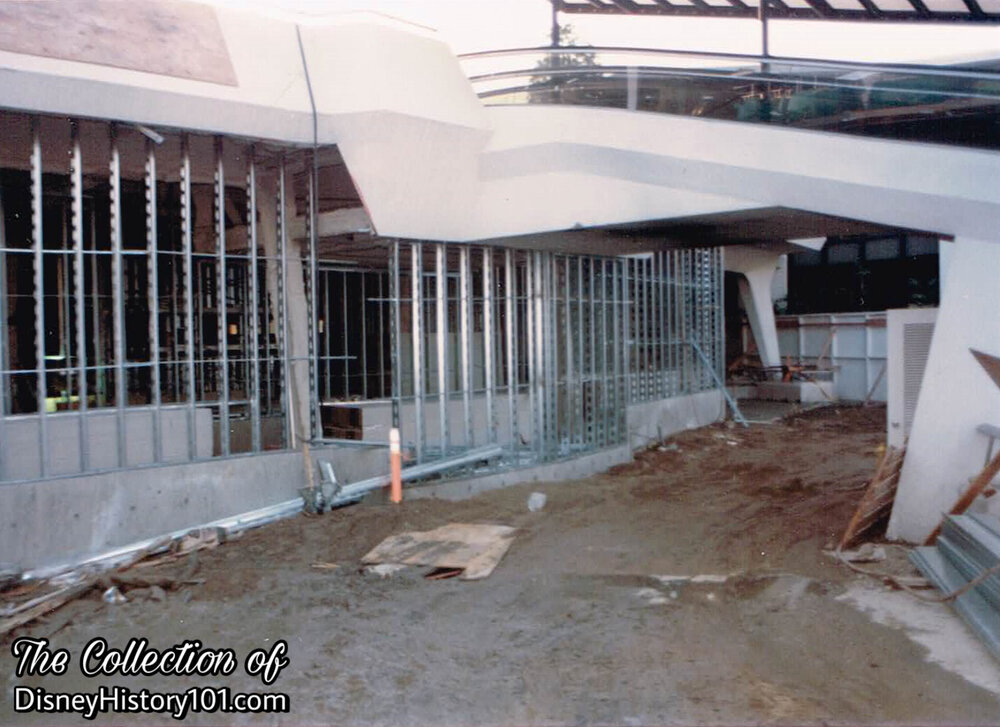

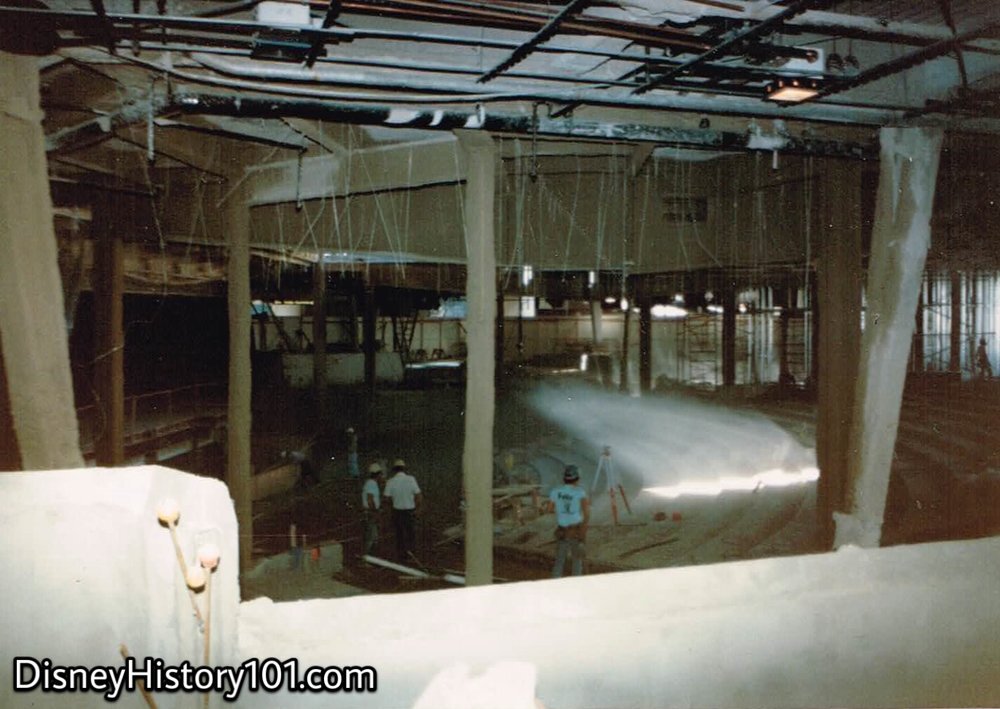
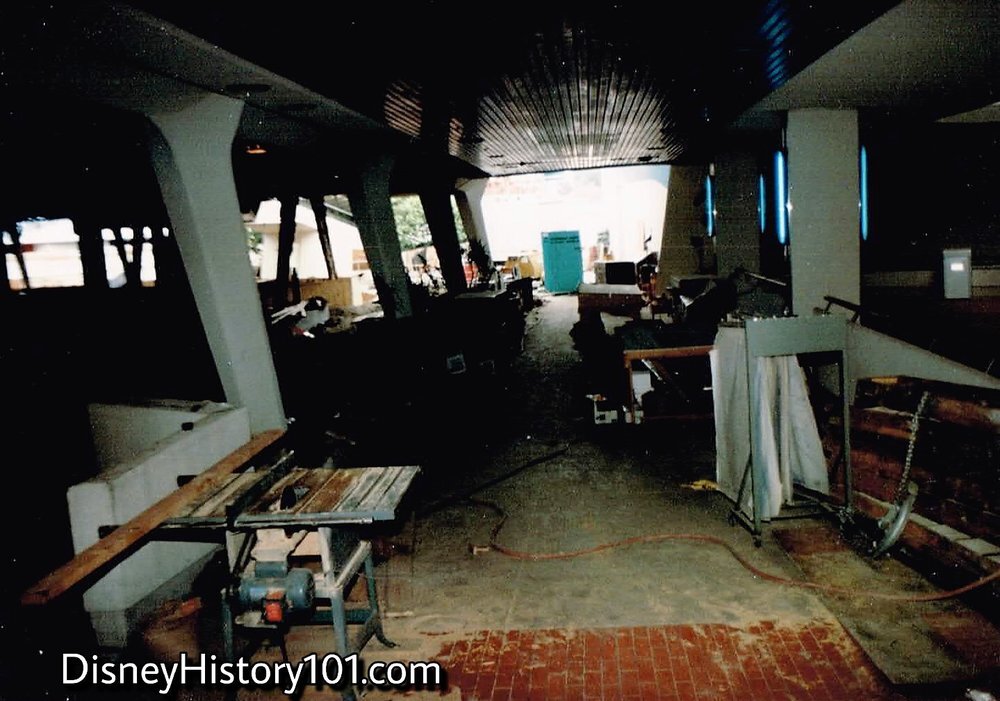
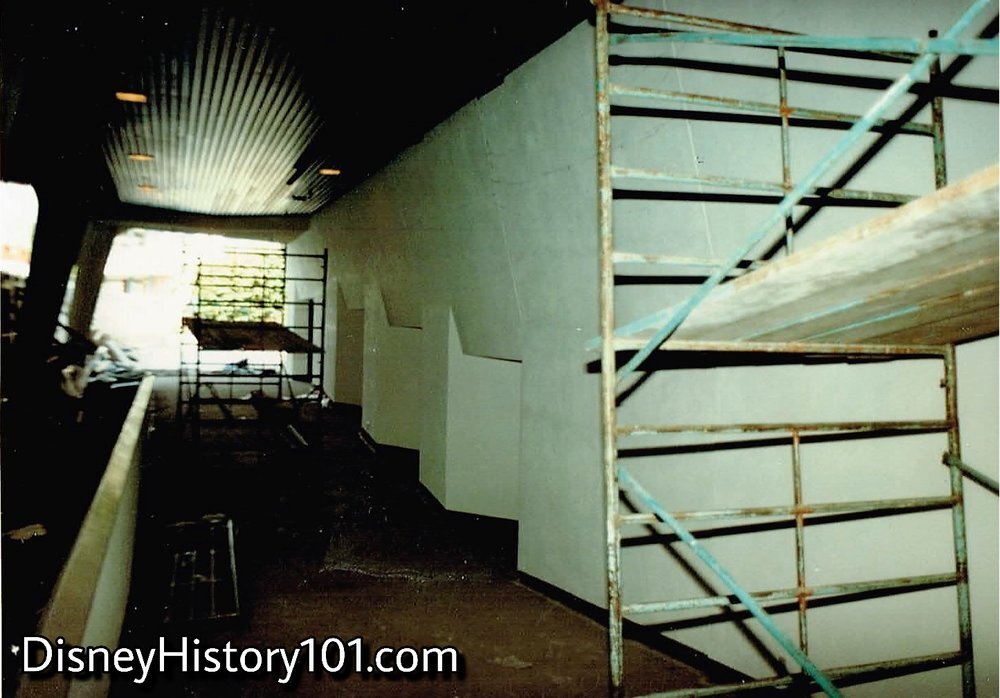
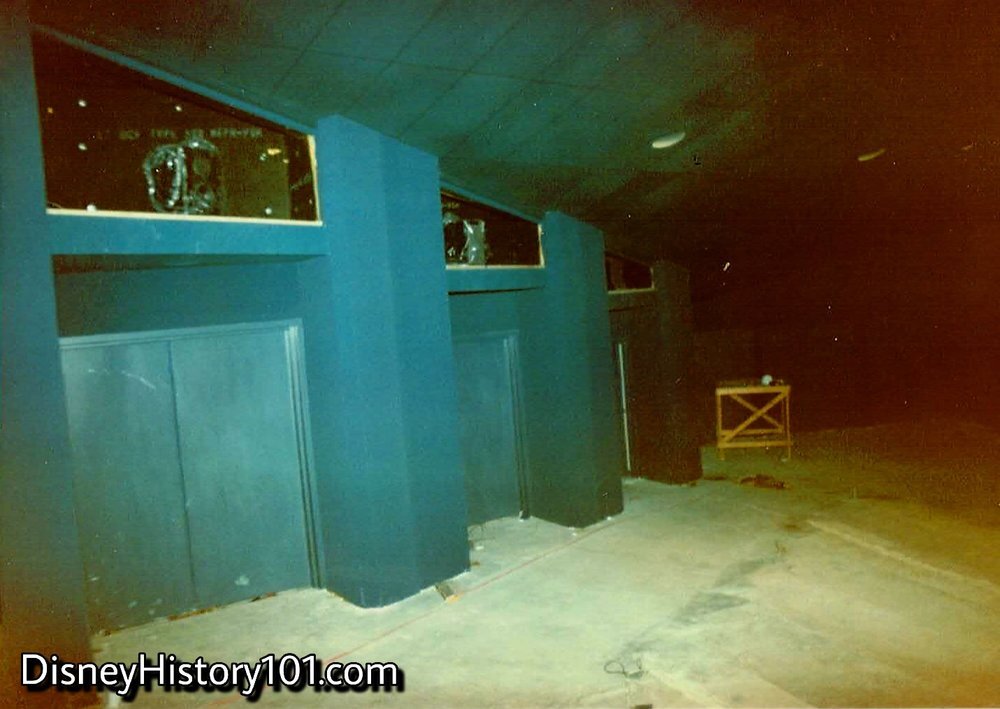
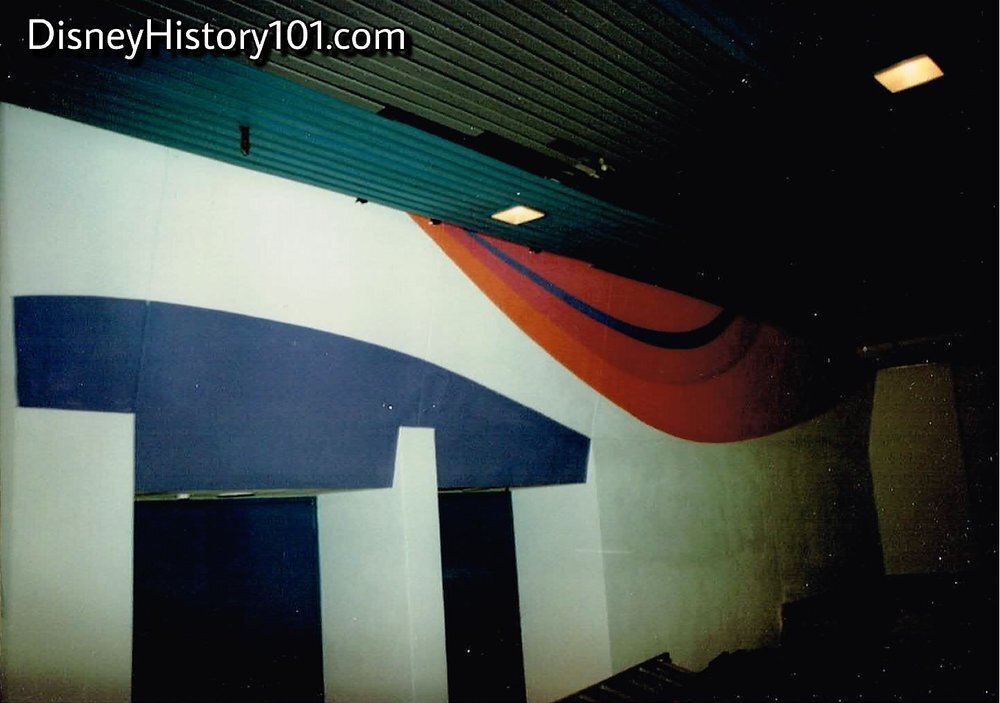
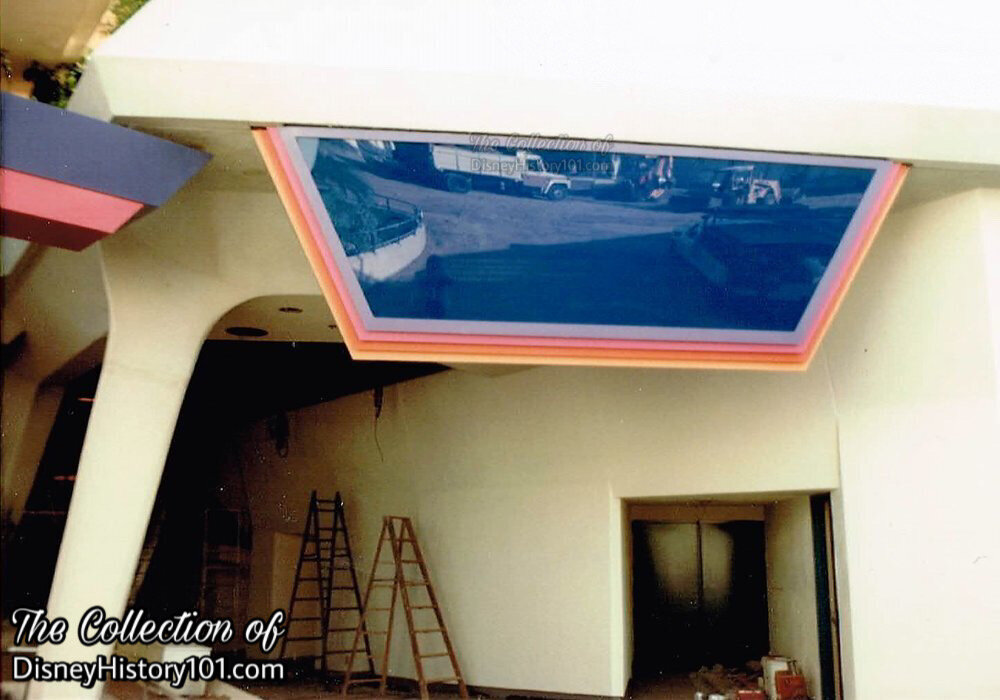
“It looks like we started something”, but guests would wait a few months until Tomorrowland’s newest space adventure would be revealed on the marquee above the entrance!

The concept of theaters in Disneyland isn’t new, dating back to the Fantasyland Theater and Tomorrowland’s CirCARama Theater of 1955. These particular theaters were unlike anything in the world - the Fantasyland Theater (dedicated to animated shorts for most of its tenure) and the CirCARama Theater (designed to show films that were shot in 360 degrees). A little more than three decades later (during the era of Michael Eisner’s & Frank Wells’ leadership), a brand new concept of theater design would push the limits of the form of Disney Parks entertainment with Magic Eye Theater!
Guests entered the Magic Eye Theater’s “Pre-Show Area” to the East (along the East Promenade), before the seven entry doors opened.
The show building held a lengthy “Projection Room” (at the rear of the theater), and a “Glasses Storage” Room (behind the Projection Room). Air-conditioning controls dust, and a practical mechanical application of the technology was essential in the attraction where projection equipment and film was used.
A console for the attraction operator was located at the front right corner of the theater (to the South-West). Finally, guests left the theater though one of the Magic Eye Theater’s four automated exit doors (to the West Promenade) at the close of the film.
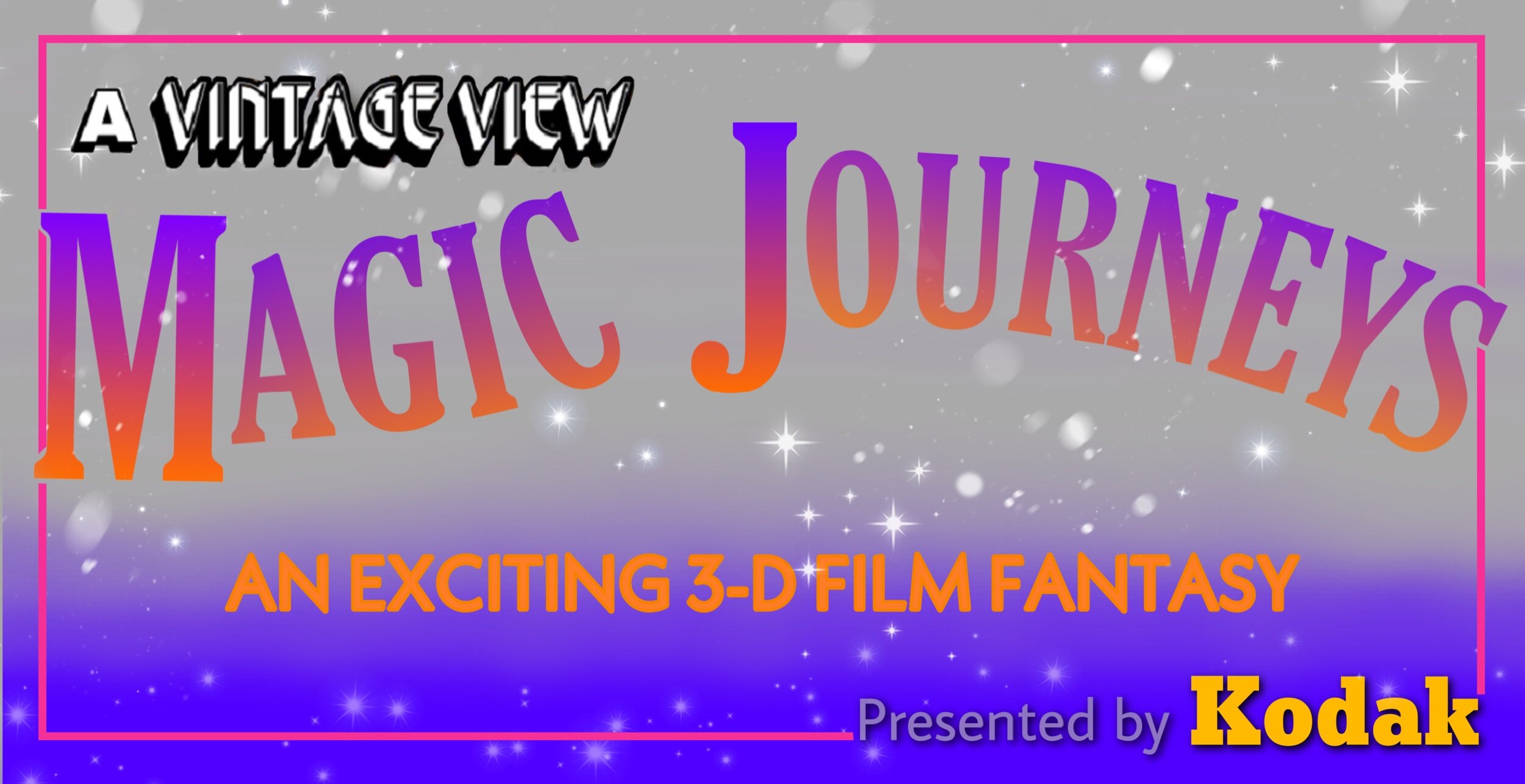
“Production - Where the Universe Begins”
The 16-minute, child-like and imaginative 3-D film (with its mesmerizing, and hauntingly beautiful theme), was directed by the then-experimental film director and producer Murray Lerner (Academy Award, 1980 ; Best Documentary Feature “From Mao to Mozart”). Rick Carter (who would, decades later, go on to serve as Art Director and Production Designer for James Cameron’s Avatar) was integral to the animation design of the film. The final film’s surreal usage of distinct and profound imagery - of clouds, dandelions, kites, a pegasus, the circus, and a magician - certainly helped viewers of all ages “make memories”. According to the Disney News (Summer, 1984), “Beginning with a handful of children racing against a meadow and gazing at clouds, it also brings a frothy pink-and-white cluster of spring blossoms right to the tip of your nose. The sense of proximity is so realistic that more than one visitor reaches out to touch them. Dandelion spores float through the air , turn into stars, and are then transformed into a sun whose rays become water right before your eyes. In another scene, a child’s kite changes from a bird to fish to a whole school of fish, to a flock of birds, bird wings, the flying horse Pegasus, a real horse, and then a spirited steed on a merry-go-round. The brass harness ring of the carousel horse floats out at the audience, tempting all to try to catch it. Then the ring itself turns into a moon, then bats, then frightening witches and their masks and finally the sphinx.”
Many-a-guest (temporarily transported inside a child’s imagination) would be left wondering, “Do they mirror what we think, or sense, or feel?” These unusual (and animated) visuals were created by Colossal Pictures, at a time when CGI was experimental and new. In fact, long before Pixar’s animated feature-length theatrical smash-hit Toy Story, the 3-D 70mm “Magic Journeys” was a contender in the Pixar Short Film Festival. “Magic Journeys” holds a record as the first 3-D motion picture to feature computer generated 3-D animation. Last, (but no less-essential to the film’s success), is the film’s theme song (or, score). “Magic Journeys” (for which the film was named) was both written and composed by the “Legendary” Richard Sherman and Robert Sherman, and sung by the Disney Studio Chorus. It is (in our opinion) the most beautiful piece that the duo has ever conceived! Richard and Robert would also write and compose the memorable “Makin’ Memories” for the pre-show area of the attraction.
“From Disneyland to Walt Disney World - All At Once, You’re On Your Way”
“Magic Journeys” had its appropriate debut at Walt Disney World EPCOT Center’s Imagination Pavilion, on October 1st, 1982). From EPCOT Center’s opening day, guests would “soar on the wings of imagination” in a way like never before, at a Disney Park. Two years later (and hot on the heals of its Epcot Center success), the exciting new 3-D film would also open at Disneyland. The venue where it would debut would be called the “Magic Eye Theater” (sponsored by Kodak Film). Though under construction, its soon-to-open its doors excited Tomorrowland guests. “Magic Journeys” would officially open at the brand new air-conditioned Tomorrowland “Magic Eye Theater” on June 16th, 1984. “Magic Journeys” was such a popular attraction, that a third film was sent to Tokyo Disneyland, and opened January 17, 1985 (replacing the film “Eternal Seas”). By this time a total of three separate Disney Parks screens were showing the one-time experimental film - “Magic Journeys”!
“In A Flash They Disappear”
A year later (in 1986), “on the wings of unexpected sounds and sights”, “Magic Journeys” finally departed from both EPCOT Center (during February 9th, 1986) and Disneyland (during July of 1986). Tokyo Disneyland was the last venue to close “Magic Journeys”, doing so during 1987. Within just two short years (by about May of 1986) of showing at Disneyland, the popular short film not only proved the potential success of 3-D animation, but the popularity of Disneyland’s own 3-D Magic Eye Theater, and this would open the door for other new adventures for decades to come! In fact, few months later, a new adventure unlike any other would debut at both the Magic Eye Theater at Disneyland and the Journey Into Imagination Pavilion at EPCOT Center!
“No Beginning, And No Ending”
During 1987, our collective “Magic Journeys” seemingly came to an end. However, this enchanting attraction (featuring some of the most cinematically ground-breaking imagery) was just too good to dispose of. As “fortuosity” would have it, another venue would soon become available, when a popular attraction would also make its move to Tokyo Disneyland. Yes, on December 15th, 1987, Magic Journeys would again debut (for its 3rd time running), this time in Walt Disney World Magic Kingdom’s own Fantasyland Theater, replacing the Mickey Mouse Revue. At this location, the “Magic Journeys” would continue for a six-year run (this time, until December 1st, 1993)!
By the end, the show bears the distinction of running on a total of four major Disney Parks screens (i.e. Disneyland Magic Eye Theater, Magic Kingdom Fantasyland Theater, EPCOT Center’s Journey Into Imagination Pavilion, and Tokyo Disneyland).
“Far From ‘An Un-Remembered Dream’”
Decades after the films debut, the imagery and the sounds of “Magic Journeys” prove it to be far from “an unremembered dream”. Still, many for audience members look back on our “Magic Journeys”, perhaps wondering “Were they real?”. For those that recollect the attraction, we search for touchstones to help us relive this attraction once again. Will the film see some form of a limited release at some time in the future? This remains to be seen. Though we currently don’t have any “Magic Journeys”Vintage Views in our gallery at Disney History 101, we hope to have caught just a few “little pieces of time, making them yours, and making them mine”, with our retrospective on the attraction!
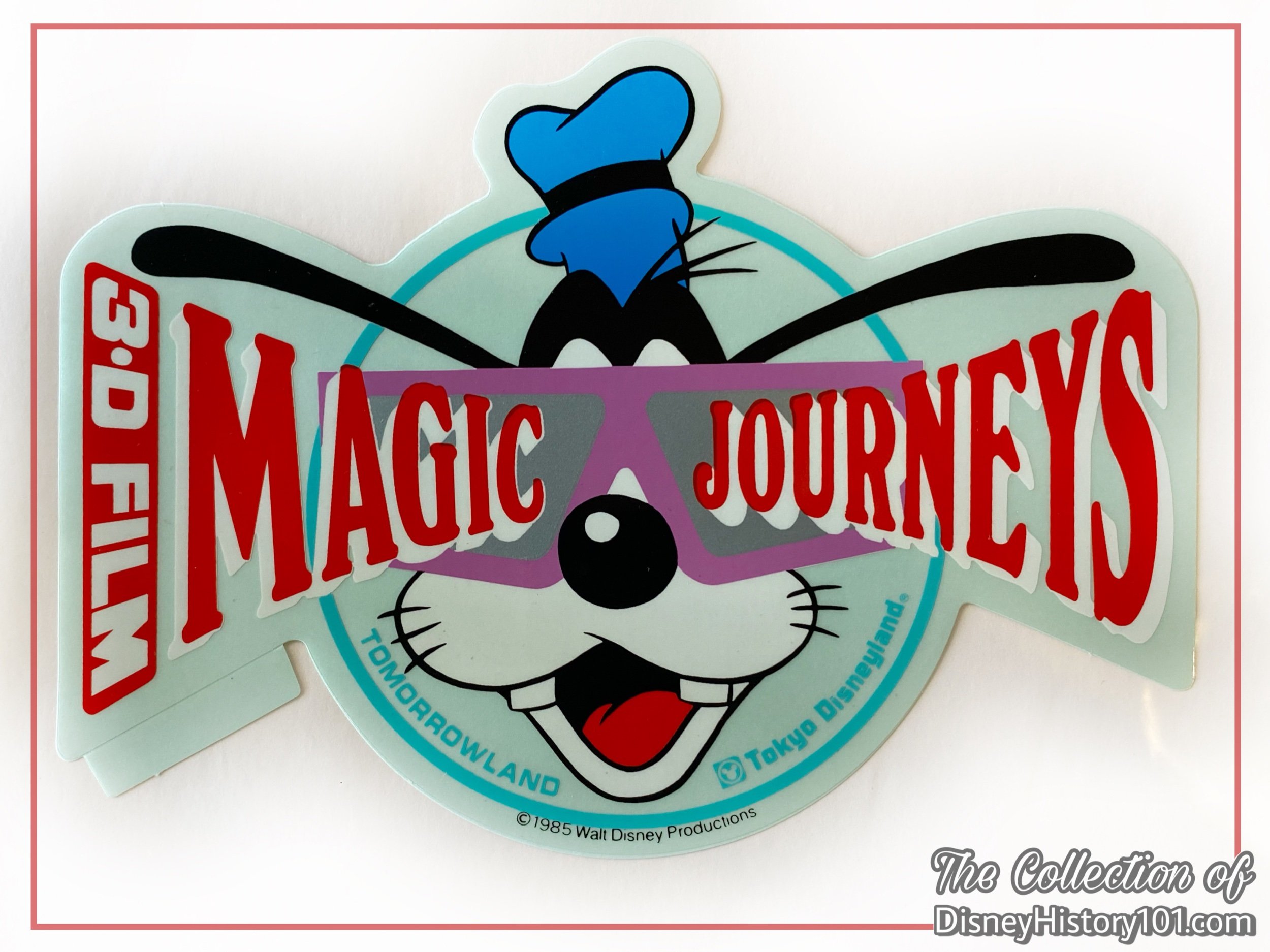

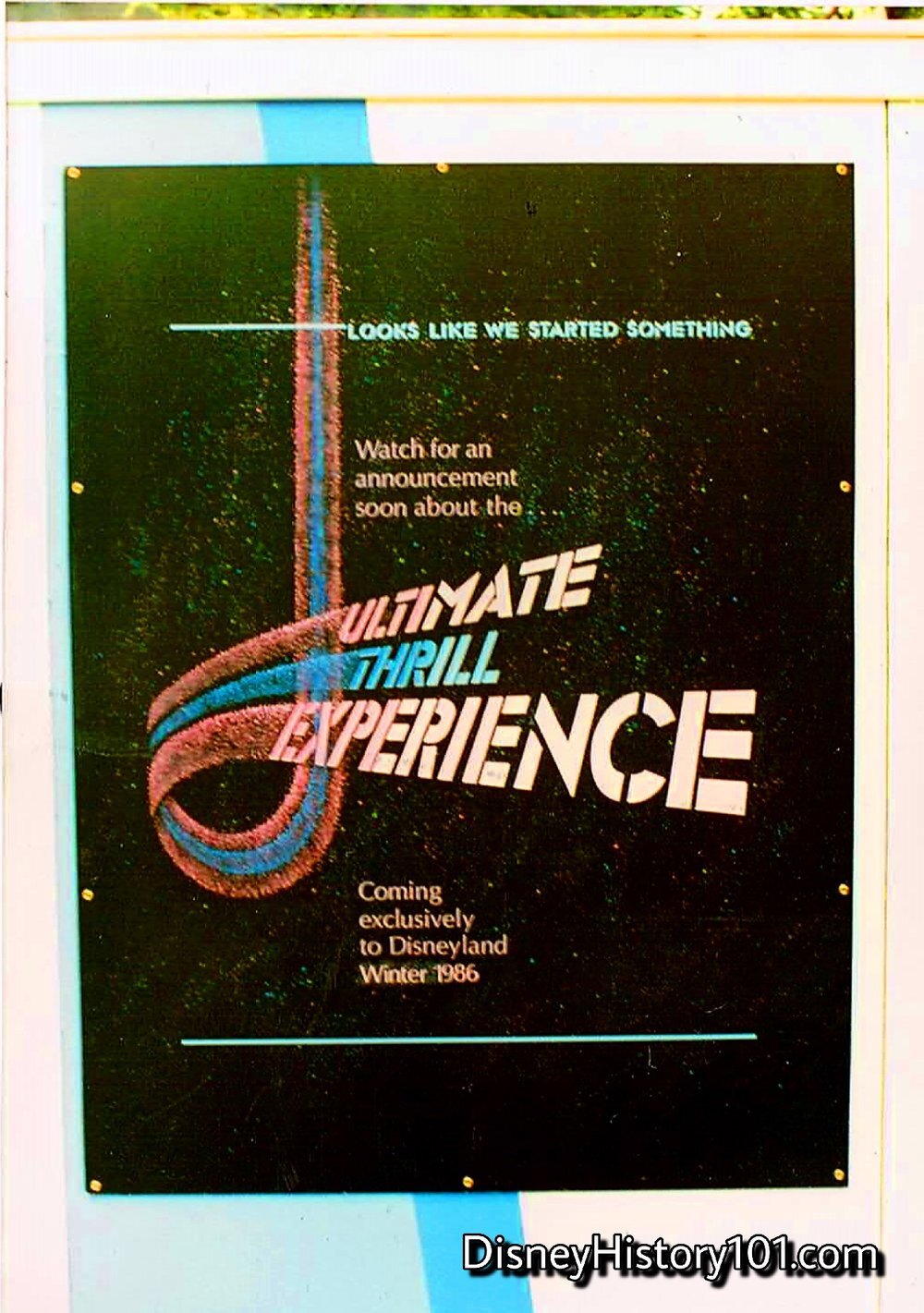
“It Looks Like We Started Something!” However, guests had to wait until the winter of 1986 for this “ultimate thrill experience” to be revealed!
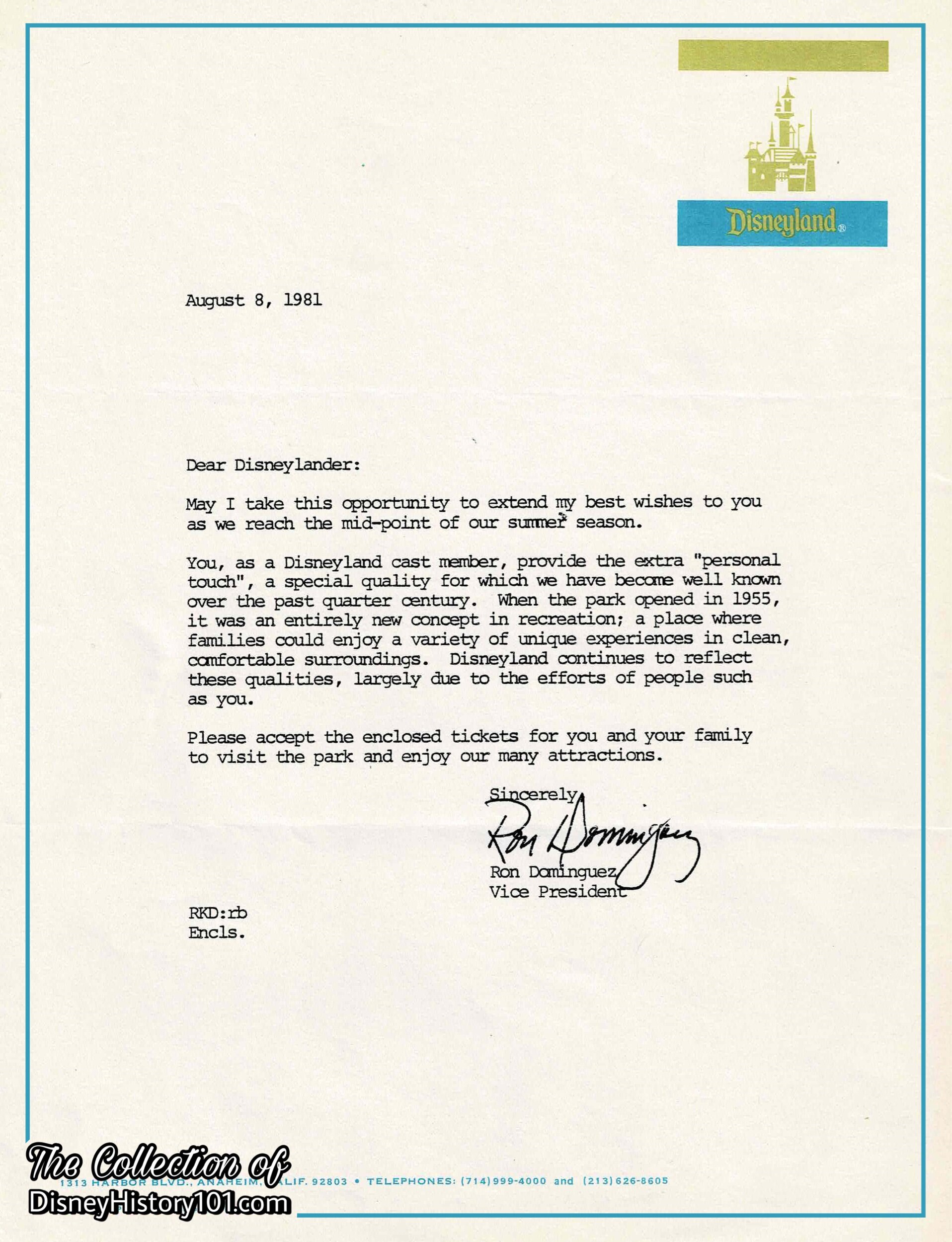
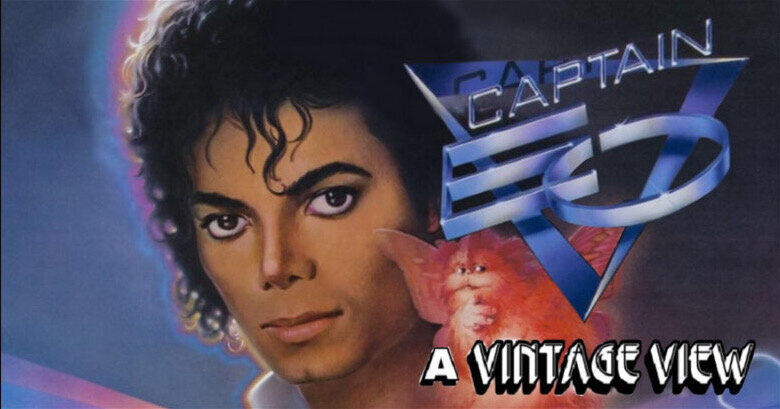
FIRST RUN (September 18, 1986 - April 6, 1997)
SECOND RUN (February 23, 2010 - 2014)
"Disneyland Enters a Whole New Dimension"
Captain EO was 3-D motion picture space adventure in Tomorrowland at DISNEYLAND, TOKYO DISNEYLAND, and in Discoveryland at DISNEYLAND PARIS.
Just how does an attraction like this come to reality? Disneyland LINE (published September 11, 1986) explains : ”’It was said that Michael Jackson was a Disney aficionado’, recalls Michael Eisner. ‘So we called him and asked if he would like to do something with the Parks. He said definitely, but only of we could get George Lucas involved. Meanwhile, George had been saying he’d do something but would have to have someone as talented as Michael Jackson be in it. So then we got Michael and George, and they both said we needed a director that was without equal. And we went right to Francis Coppola.”
Francis Coppola was truly without equal during the era, having directing award winning films as Caddyshack and Yentl. Another talent included the renowned Italian cinematographer Vitorio Storaro, who acted as a visual consultant during the two week shoot. John Napier acted as theater and costume consultant to Captain EO.
A version of the script entitled “Captain Eo and the Space Knights” had been prepared by April 29, 1985. That draft of the script was almost recognizable with characters Captain EO, Major Domo, Minor Domo, Ody & Idy, Flutter, and “an odd-looking three foot high pink elephant-like creature called Hooter.” The villain - the “High Leader” - is also referred to as the “High Witch” I the script.
Joe Rohde was a designer and scenic painter for the Captain EO 3-D film. Joe believed: “We design places. My philosophy about research is that in order to make places, you have to know places, and in order to know places, you have to go to them.”

The planets were certainly “lining up…and bringing brighter days” as the new show headed to the Magic Eye Theater during the Fall of 1986! Yes, the Walt Disney Company, Executive Producer George Lucas, invited audiences to experience a “once-in-a-lifetime motion picture experience” - a 3-D musical space adventure starring Michael Jackson singing original songs, in a Francis Ford Coppola film written by George Lucas! Only two theaters in the world would exclusively run this film - and one of them was at Disneyland! Soon, Space ships and lasers shot over the audiences’ heads, and Michael Jackson seemed to dance right off the screen and toward guests in crystal clear 70mm 3-D stereo film images. In addition, pyrotechnics enhanced the show experience. By Sunday, May 15th, the televised audiences were treated to a behind-the-scenes look of the production in “Captain EO - Backstage,” hosted by Whoopi Goldberg.
On July 24th 1986, at 9:00 pm, a Private Screening of the 17-minute film Captain EO was held in Tomorrowland’s Kodak Magic Eye Theater. A few months later (and in the great tradition of Disneyland attraction opening events), the Captain EO Grand Opening Parade and Grand Opening NBC Television Special was recorded live (by Marty Pasetta Productions) from Disneyland on Saturday, September 13, 1986. The Galactic Premier of Captain EO (for Cast Members) occurred five days later, on Thursday, September 18th, 1986 (from 8:00 PM to Midnight), including a complimentary meal at The Space Place or Tomorrowland Terrace. The public unveiling took place the following day (on September 19th), a day before the television special (hosted by Patrick Duffy and Justine Bateman) aired on Saturday, September 20, on NBC. Horseless Carriage Club of Southern California members (wearing turn-of-the-century wardrobe) shuttled approximately 75 notable celebrities (like Margot Kidder, Jane Fonda, O.J. Simpson, Patrick Duffy, Dorothy Hamill, Charles Bronson, Alan Thicke, and Nell Carter) down Main Street U.S.A. and toward a reception at the Plaza Inn. (As a “sidelight”, Marty Pasetta Productions made a donation to the Horseless Carriage Club of Southern California in a special agreement).
There, the invited guests awaited the grand ribbon cutting ceremony presided over by Francis Coppola, Anjelica Huston, and George Lucas. Then the invited guests were off to the big “Premiere” showing under the fiber optic star field! As guests exited the Magic Eye Theater, an instrumental track of Michael Jackson’s “Another Part of Me” (originally recorded during 1985 and 1986) could be heard. Even more - guests who were “there to change the world” during the Premier Weekend, could exchange their ticket vouchers for a “Captain EO Starfighter T-Shirt.” The premier party continued for a total of 60 hours, until 10 p.m., on September 21st.
By August 21, 1986, "Captain EO“ Attractions Hosts and Hostesses administered the following Theater Load Live Spiel: “Please move all the way across your row, filling in every available seat. The 3-D glasses are designed to fit comfortably over your prescription glasses. At the conclusion of Captain EO, we ask that you return the glasses to the bins after you exit the theater. The glasses were not intended for use outside of this theater and will impair your normal vision.”
Celebrations were in order for Walt Disney Company employees at “Walt Disney Imagineeringland” on November 15 & 16, 1997. A Captain EO Video Insert Stage was shown every half hour beginning at 9:30.
Captain EO returned for another run (as a posthumous tribute to the “King of Pop”), starting February 23, 2010. The attraction was then billed as Captain EO Tribute! It ran until sometime before Marvel Studios’ Guardians of the Galaxy sneak peek (in on July 4th, 2014).
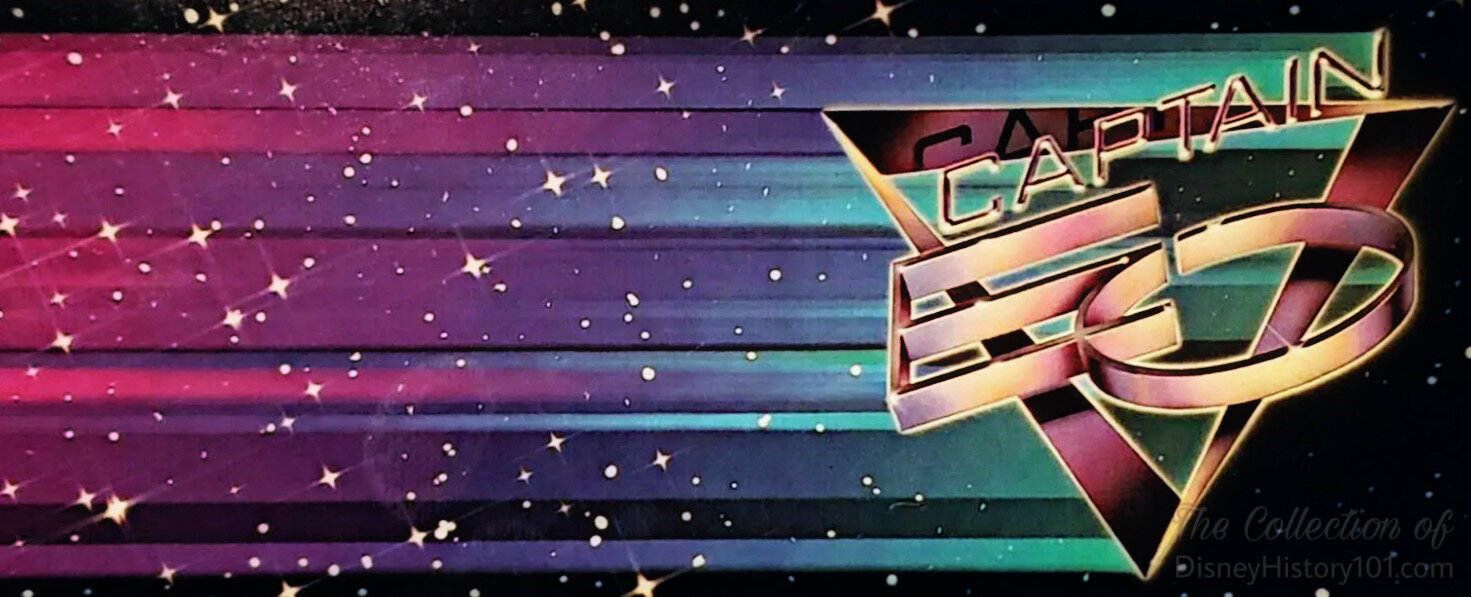
CAPTAIN EO PRE-SHOW SPIEL
“Good (morning, afternoon, evening), ladies and gentlemen. Captain EO is a 3-D Science Fiction adventure film. Some scenes may be frightening for young children; Parts off the sound track are played at a very high volume. If you are accompanying children under the age of seven or if you have sensitive hearing, please exercise discretion. I'd like to ask those of you nearest our theater entrance to please stand back until the automatic doors have opened completely.
As you enter the theater, please keep your party together and move all the way down your row, filing in every available seat. There will be roomfor everyone. For your safety, please do not put on the 3-D glasses until you are seated inside the theater. Please watch your step as you enter, and we hope you enjoy Captain-EO. Thank you.”
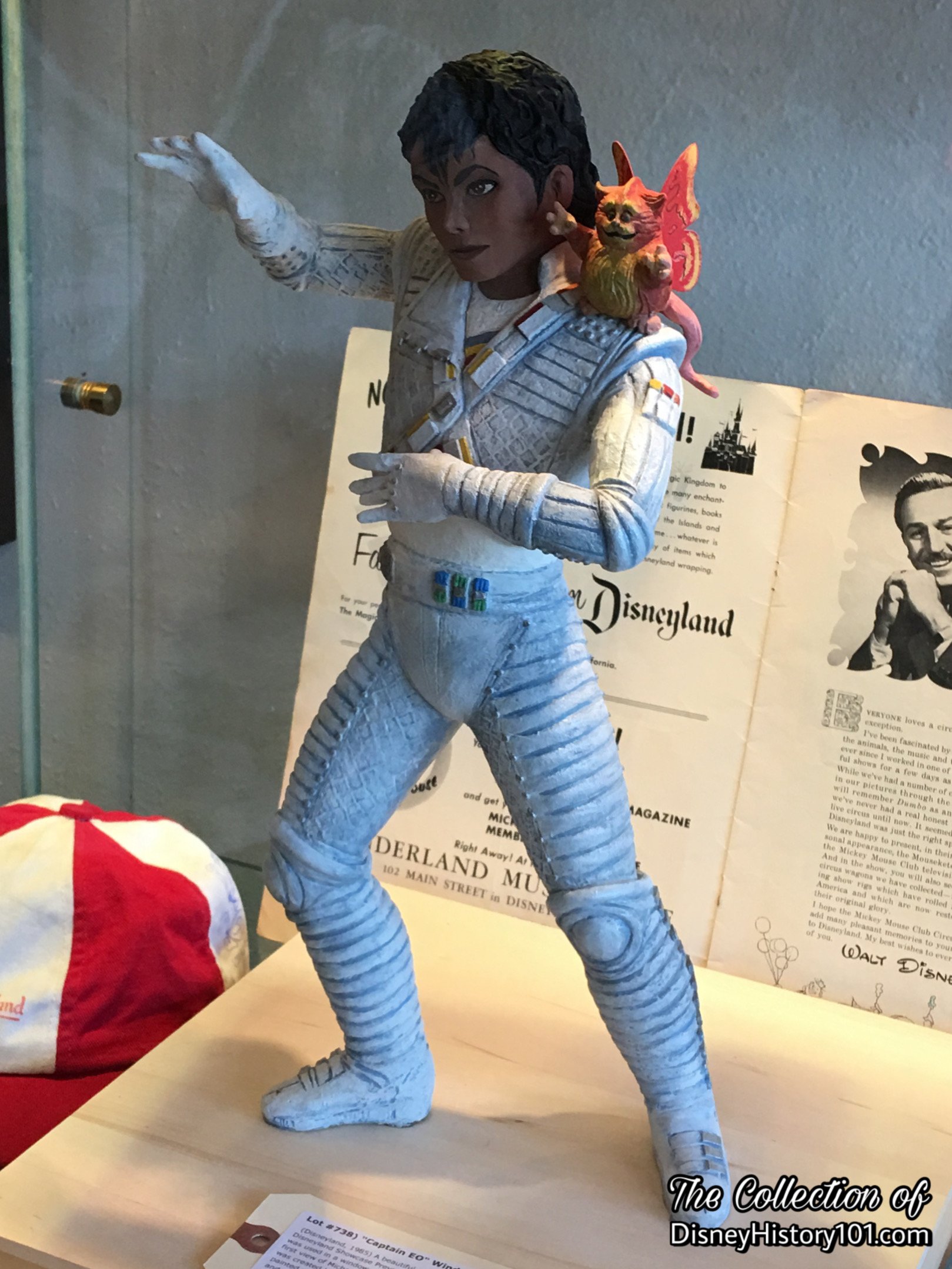

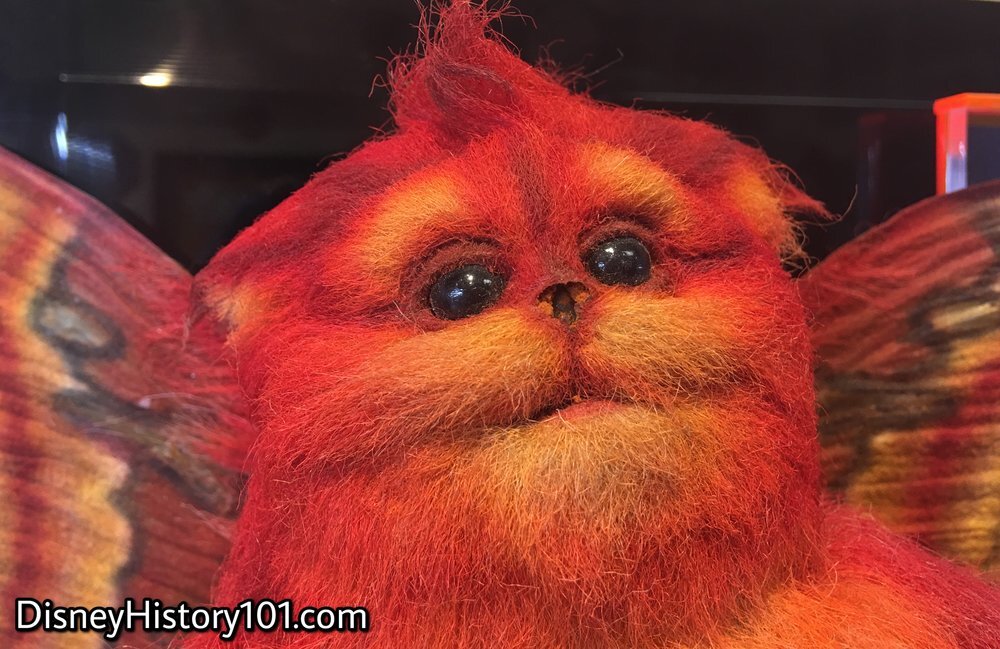
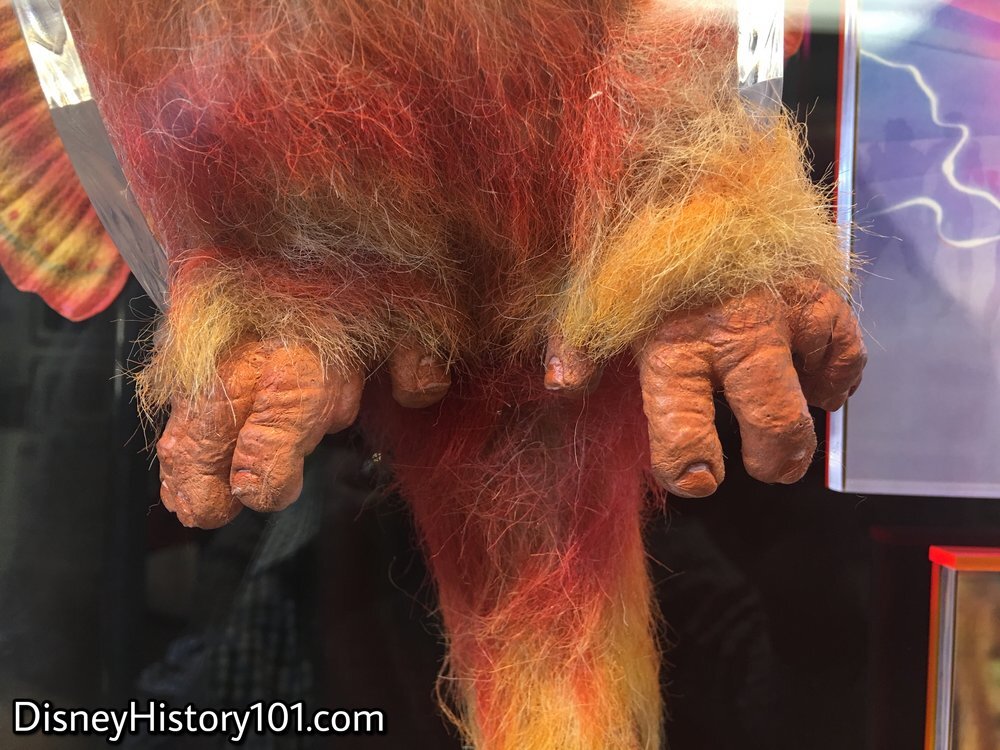
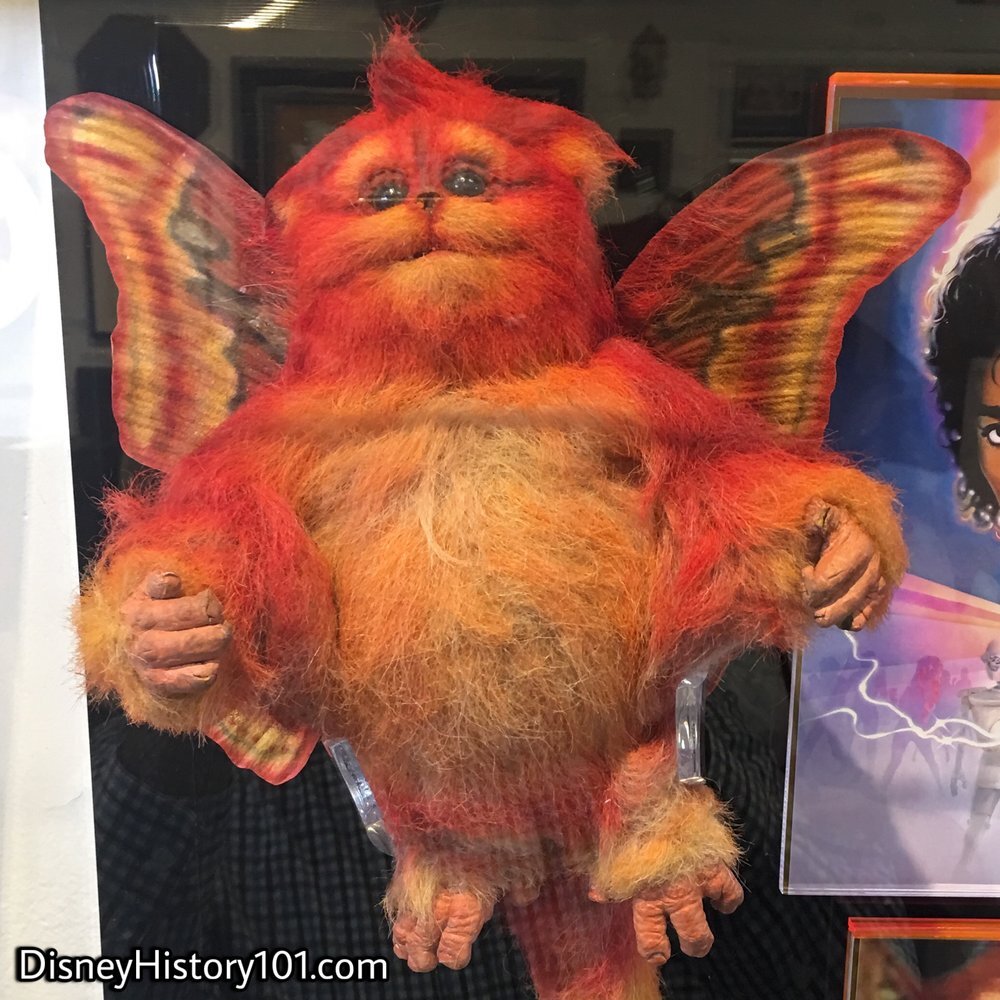
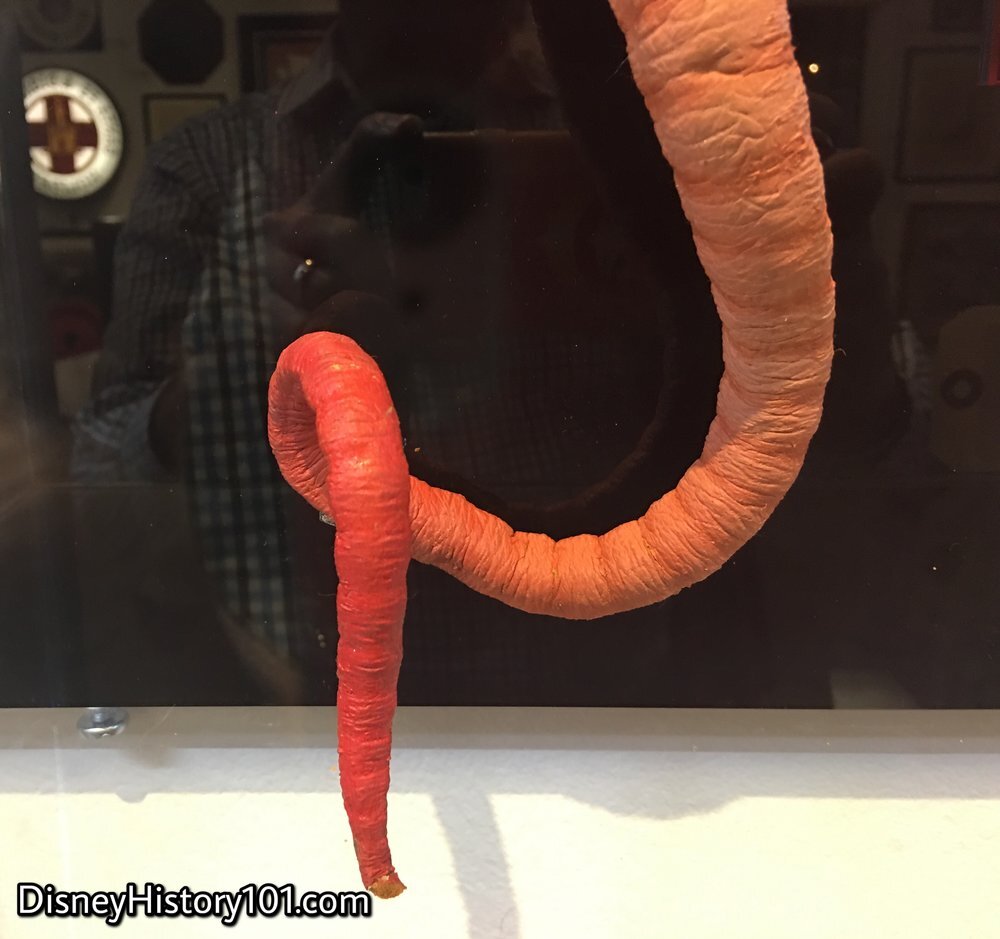
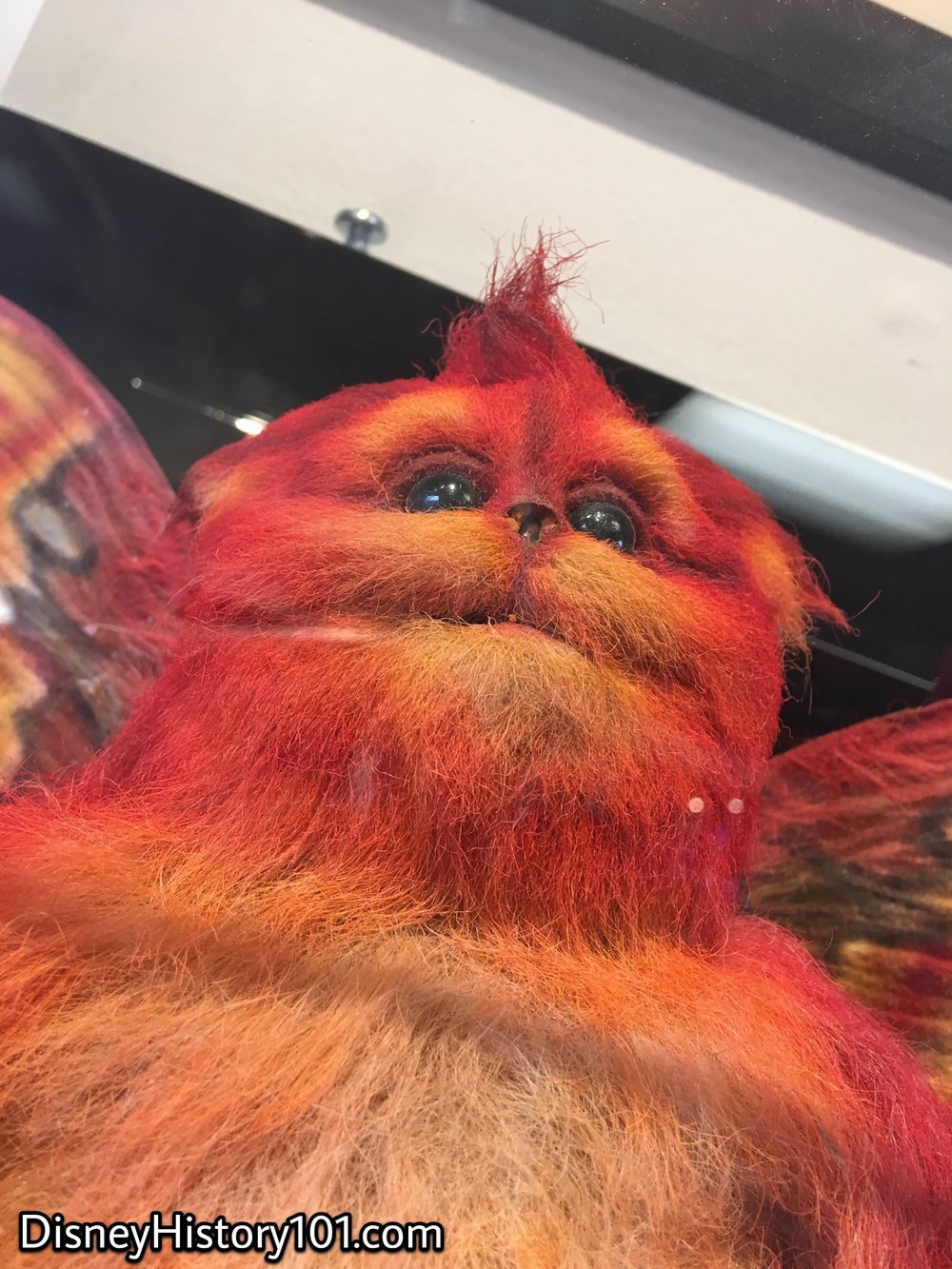
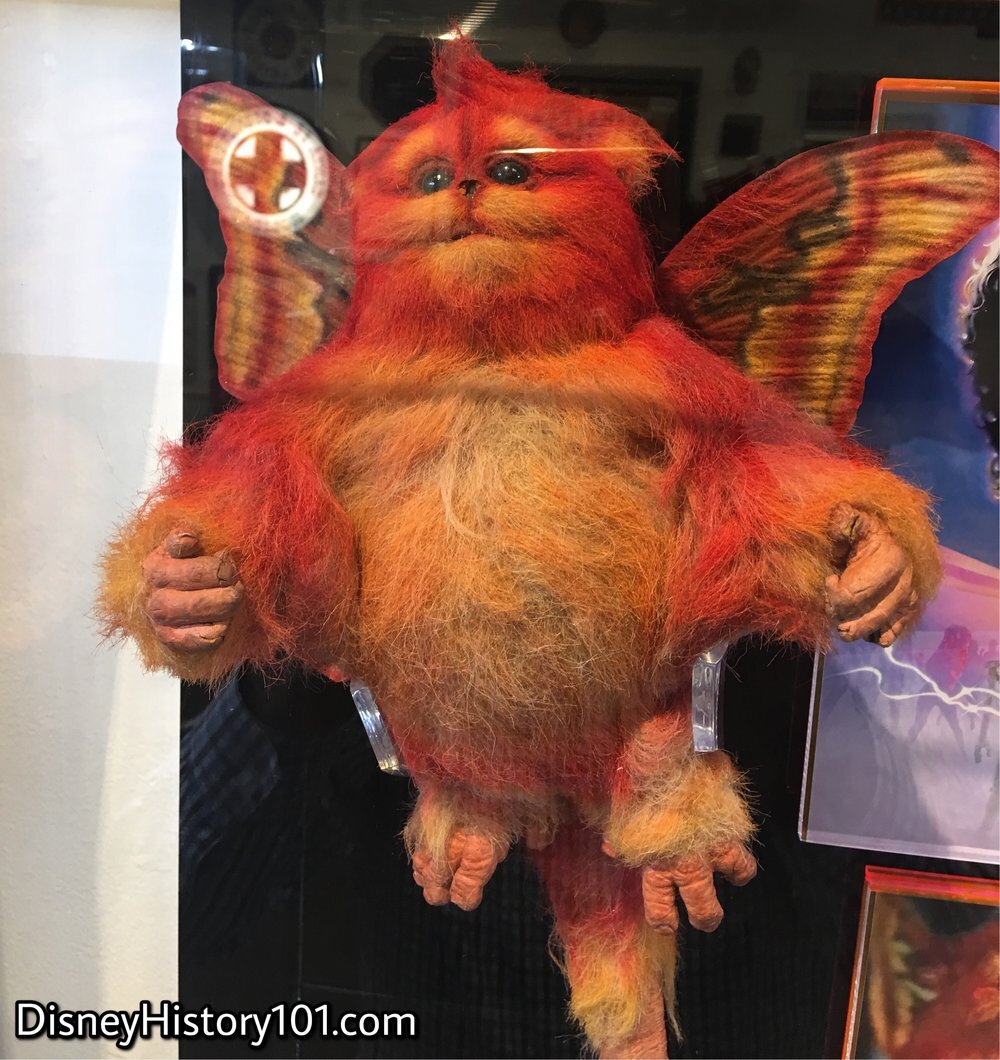
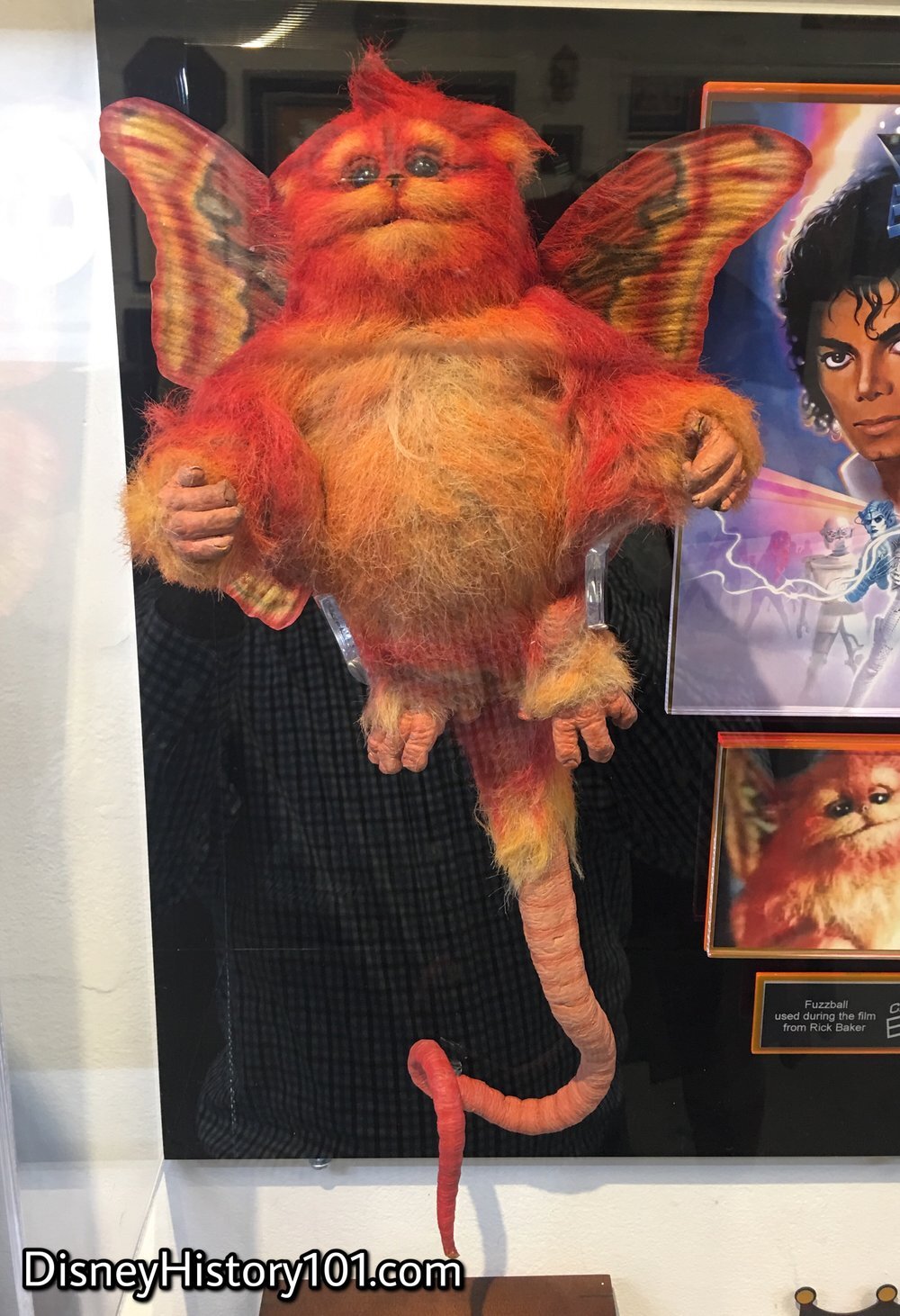
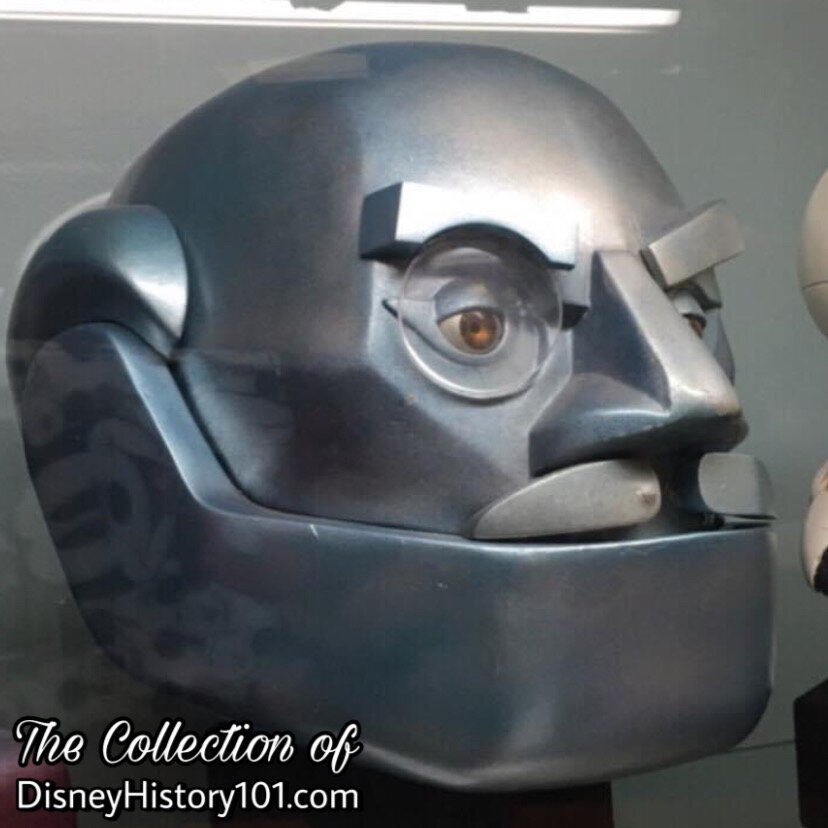
Captain EO's security officer used his head, to "change the world". Now it's on display in the Archives!
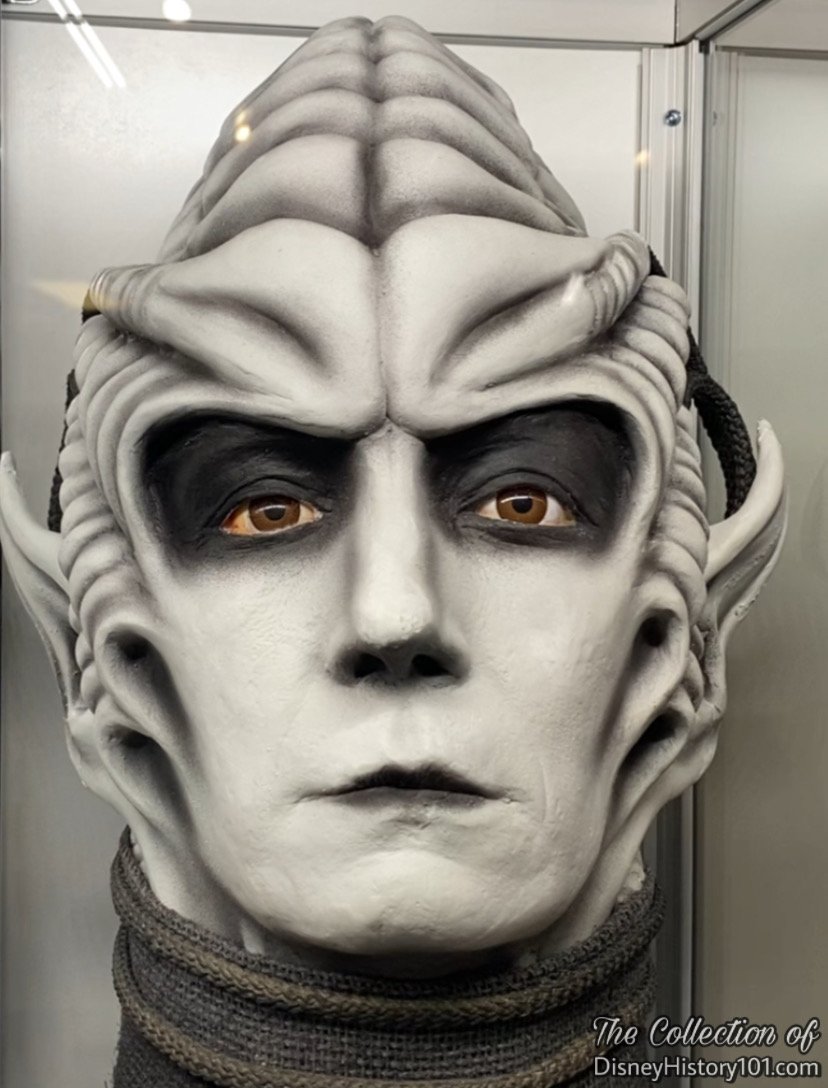
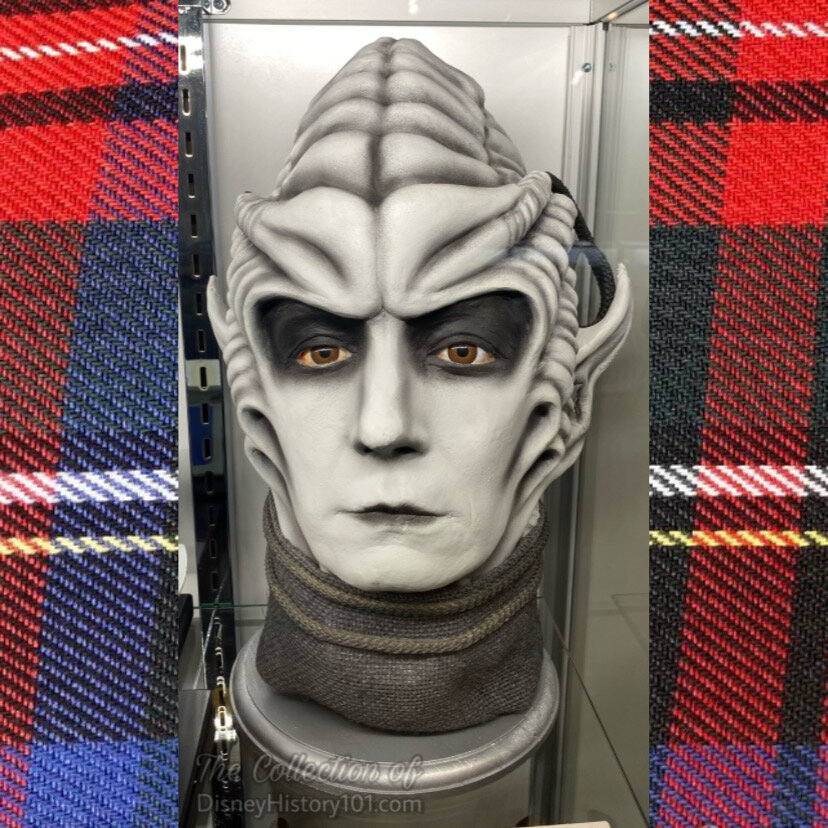
The following “Disney History 101 ‘Art-i-Fact’” was created for a particular 1980s science fiction film written by George Lucas, exclusively for Disneyland...but its not what you may think!
This life-like “Captain EO Supreme Leader Makeup Test Head” was used to test the prosthetics and makeup that would be used to bring to life ✨“another part”✨ of the Supreme Leader (portrayed by Anjelica Huston) in the 1986 musical Magic Eye Theater film 🌈 Captain EO!
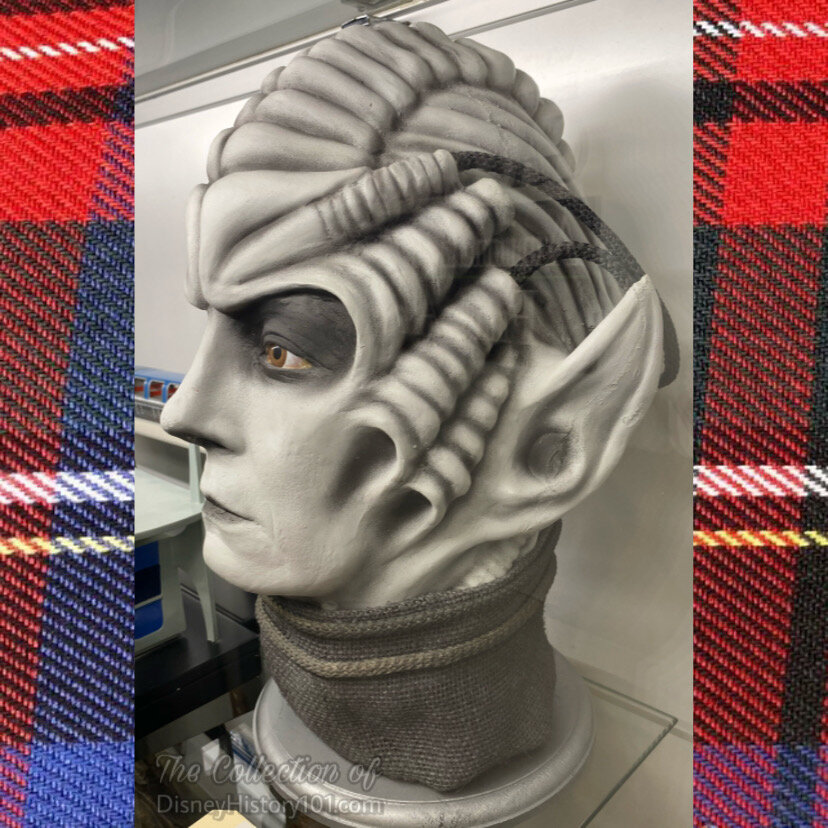
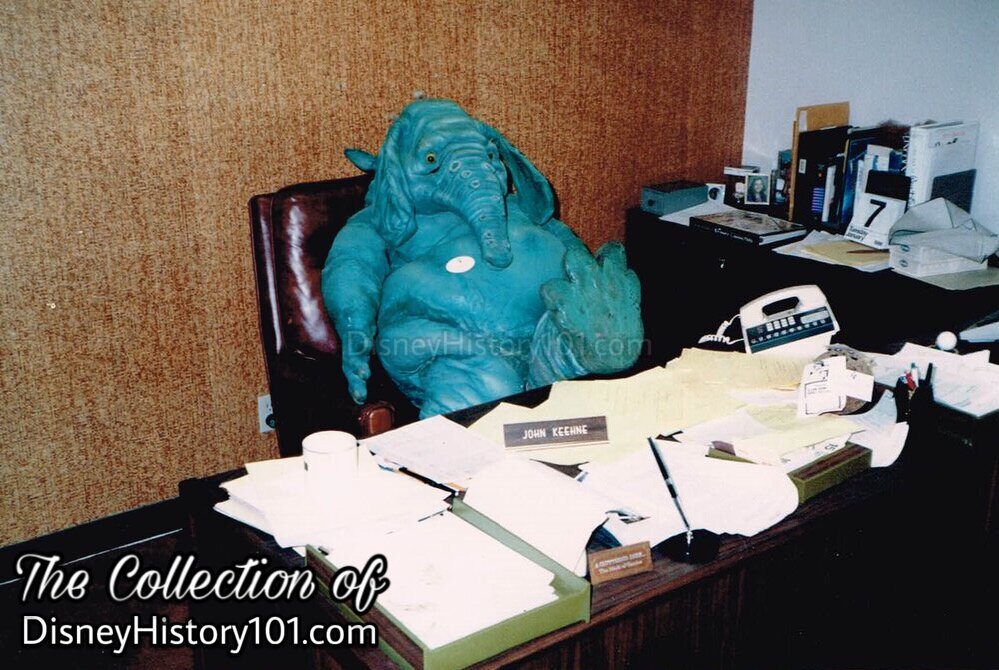
Captain EO costar Hooter makes himself comfortable in his new Disneyland Entertainment Costuming Department office, c. 1986!
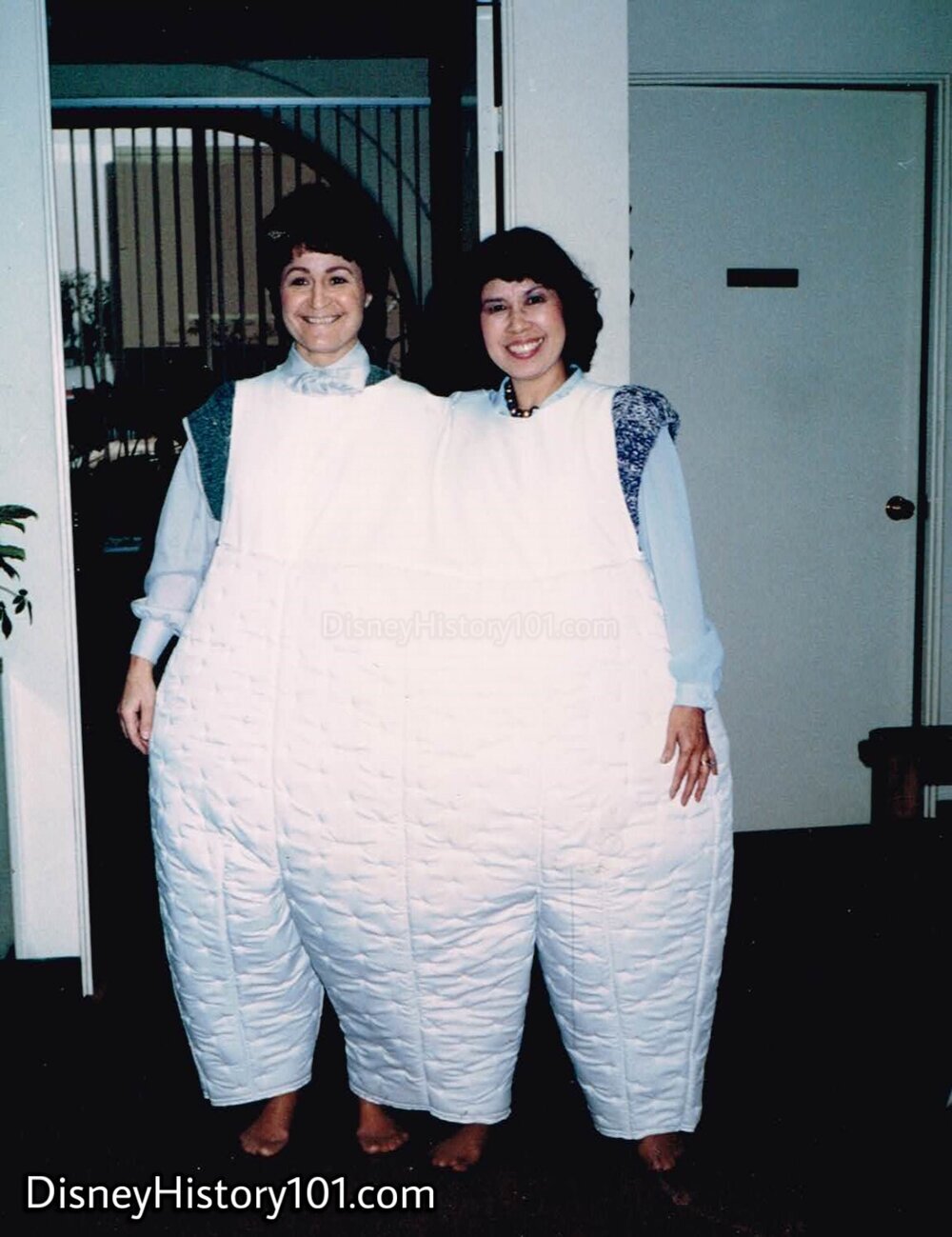
A Disneyland attractions needs characters, provided by Disneyland Entertainment Costuming Department. In this rare “Vintage View”, Shinko (pictured right) and another employee model the inner lining of the two-headed Idey and Ody costume!
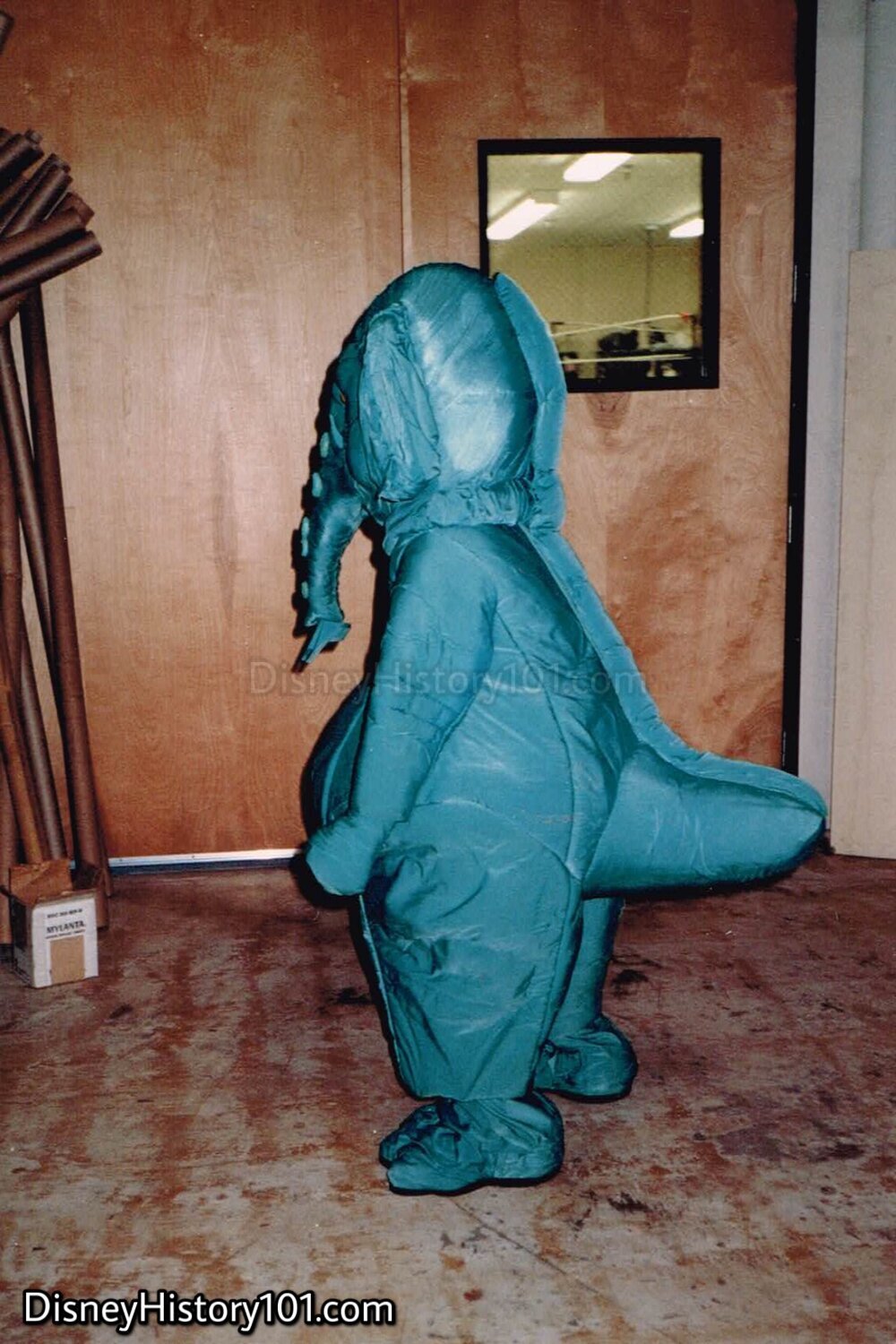
In another rare “Vintage View”, we get a glimpse of an early version of the Hooter character created by Disneyland Entertainment Costuming Department.
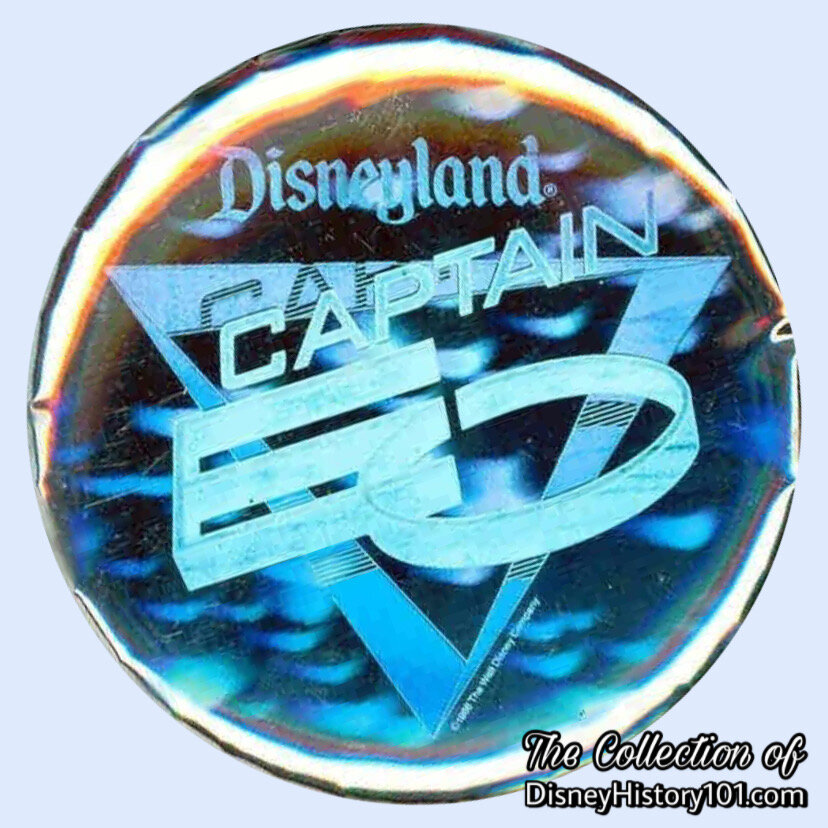

And now, please put on the 3-D glasses, as Kodak and the Walt Disney Company proudly present Captain EO!

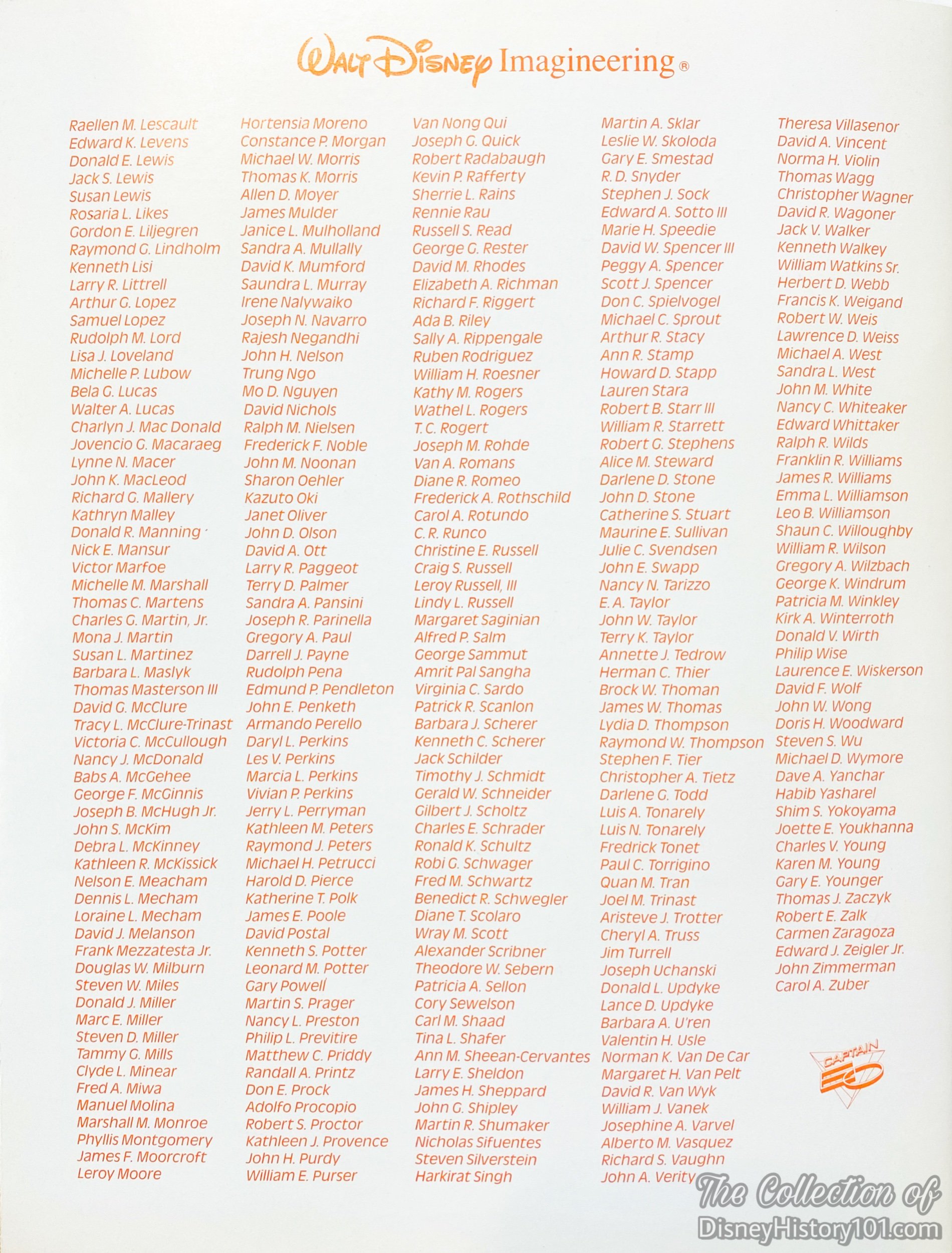
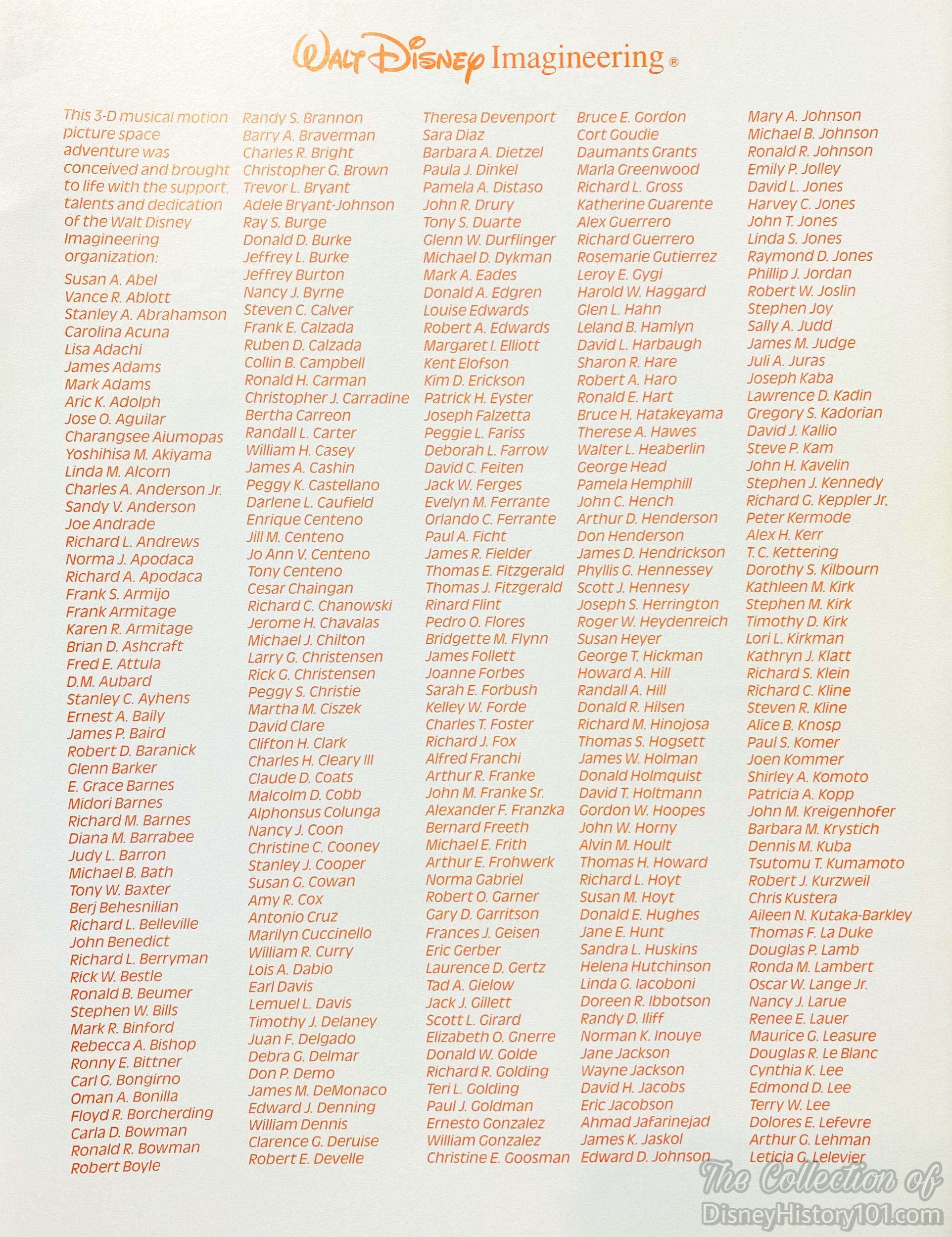
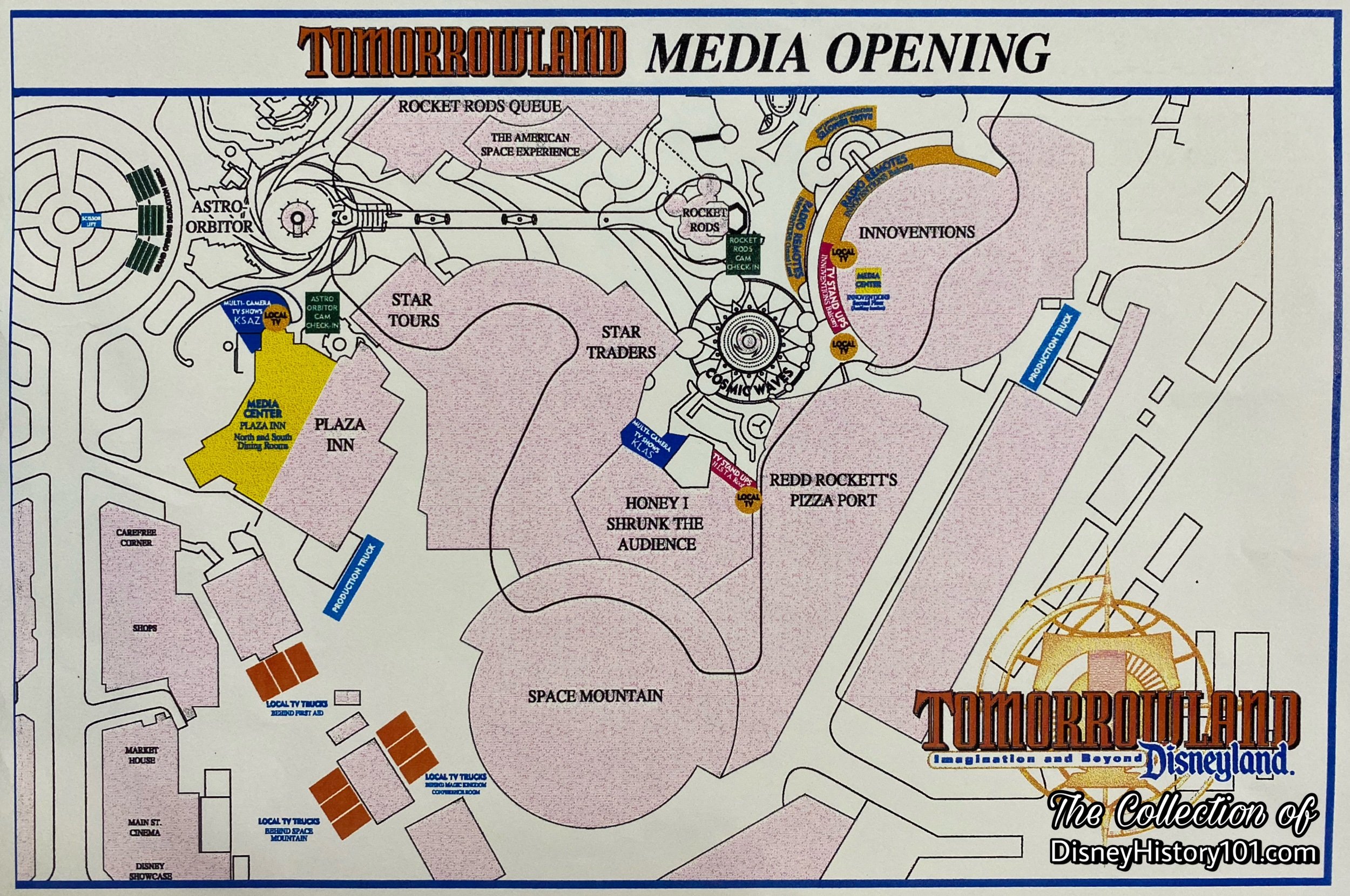
During May 20-22, 1998, Honey, I Shrunk the Audience introduced guests to the Imagination Institute, where they attended an awards show honoring Wayne Szalinski as Inventor of the Year in a humorous, special effect-filled 3-D misadventure. The show (with a run time of 18:21) was presented by Kodak and could accommodate approximately 500 guests.
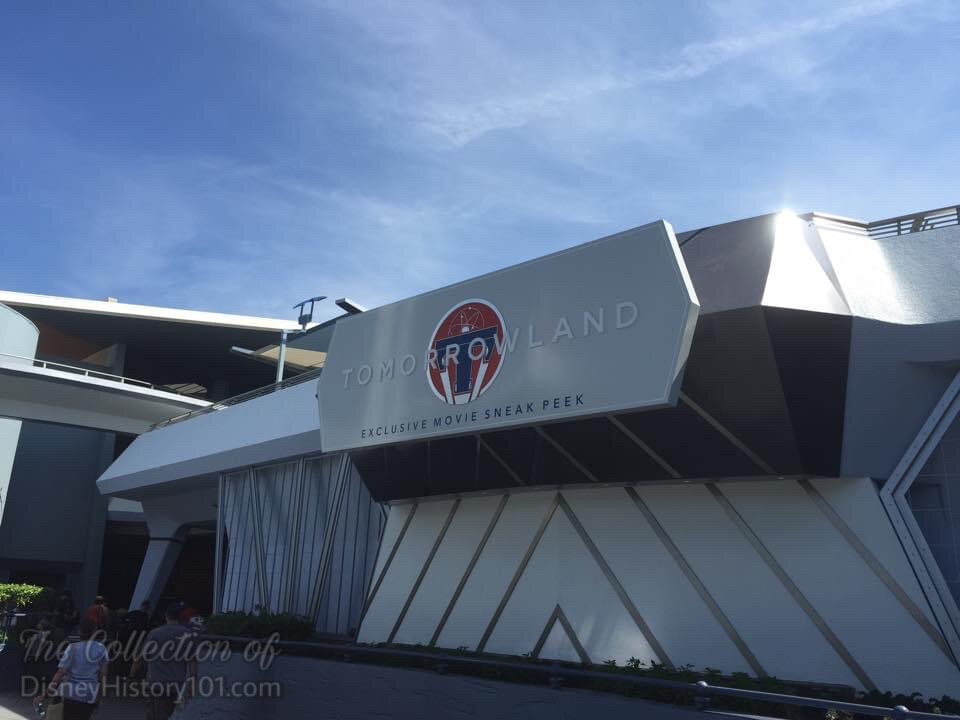
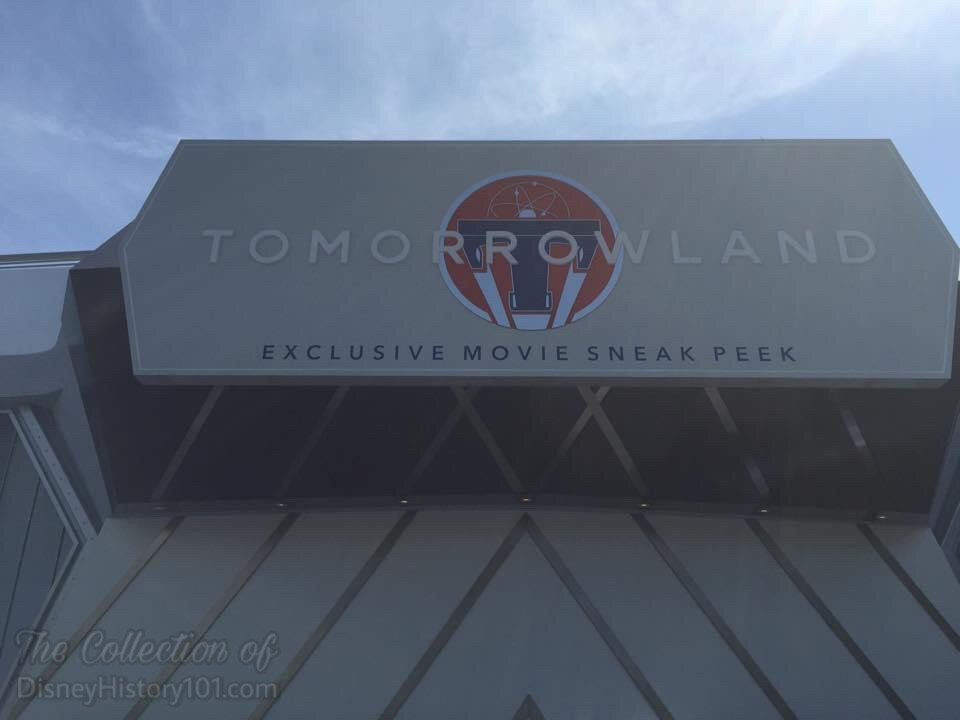
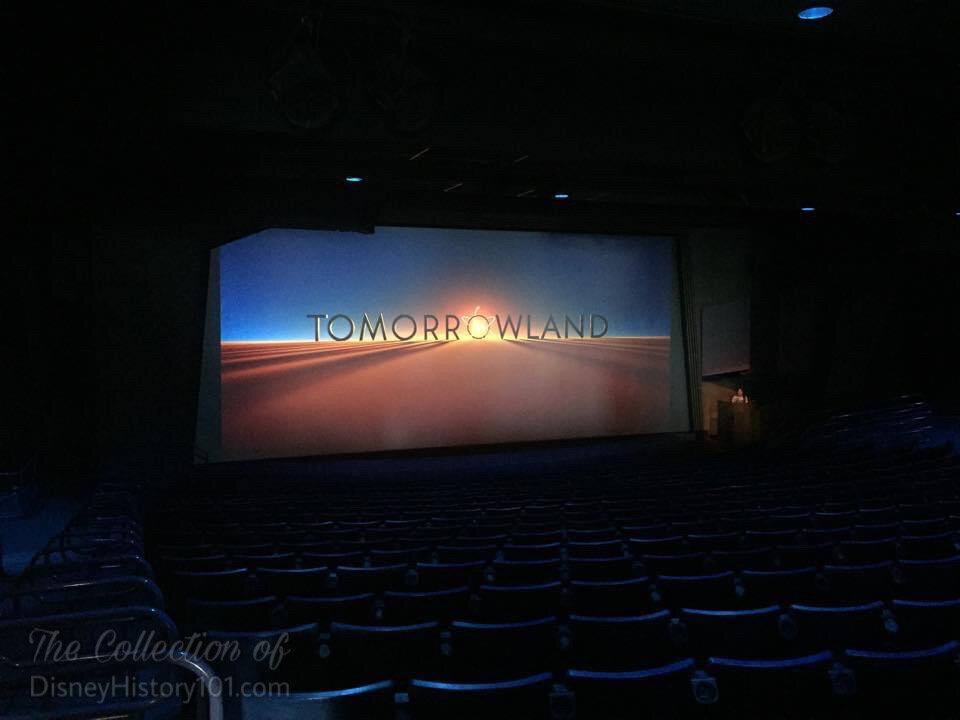
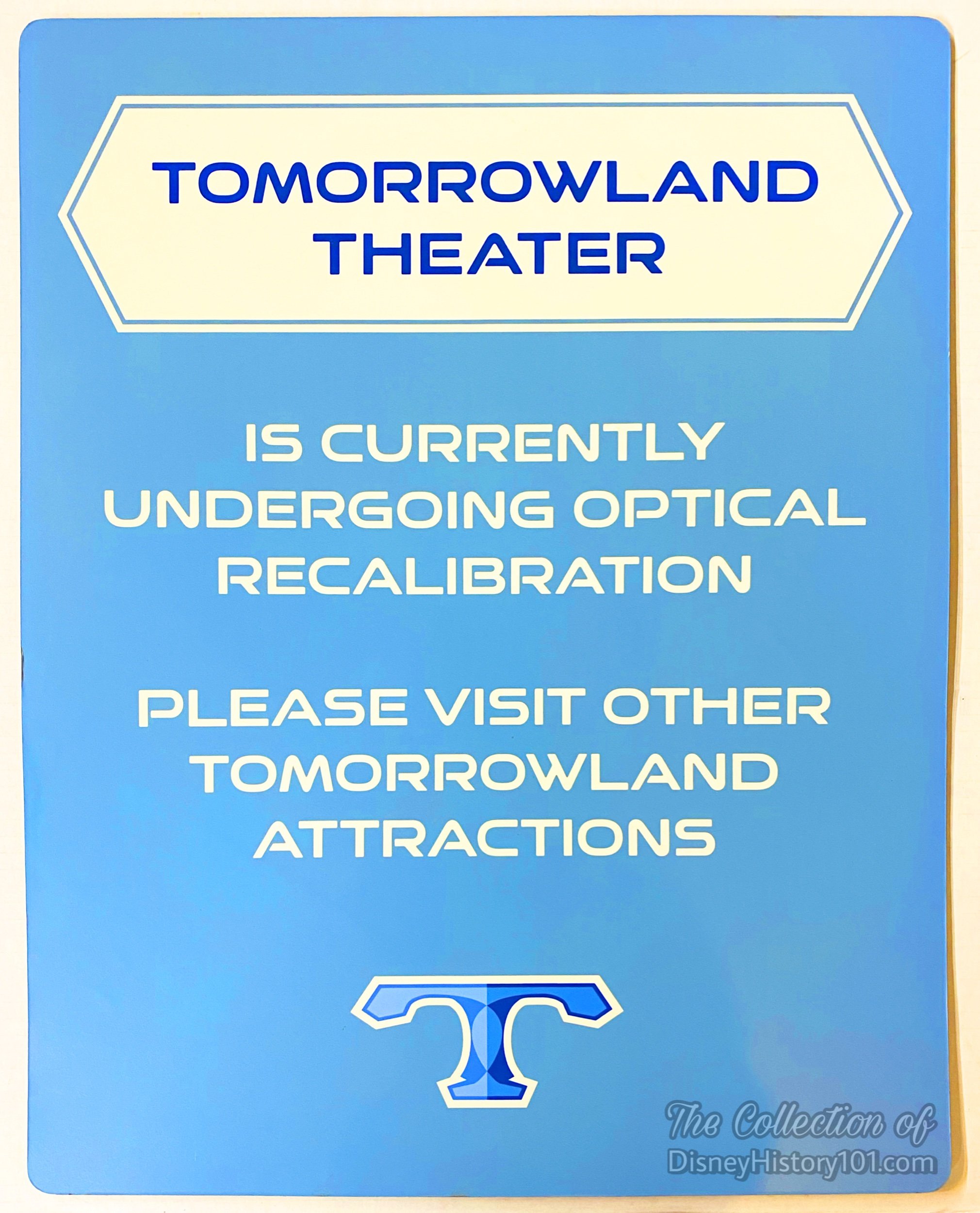
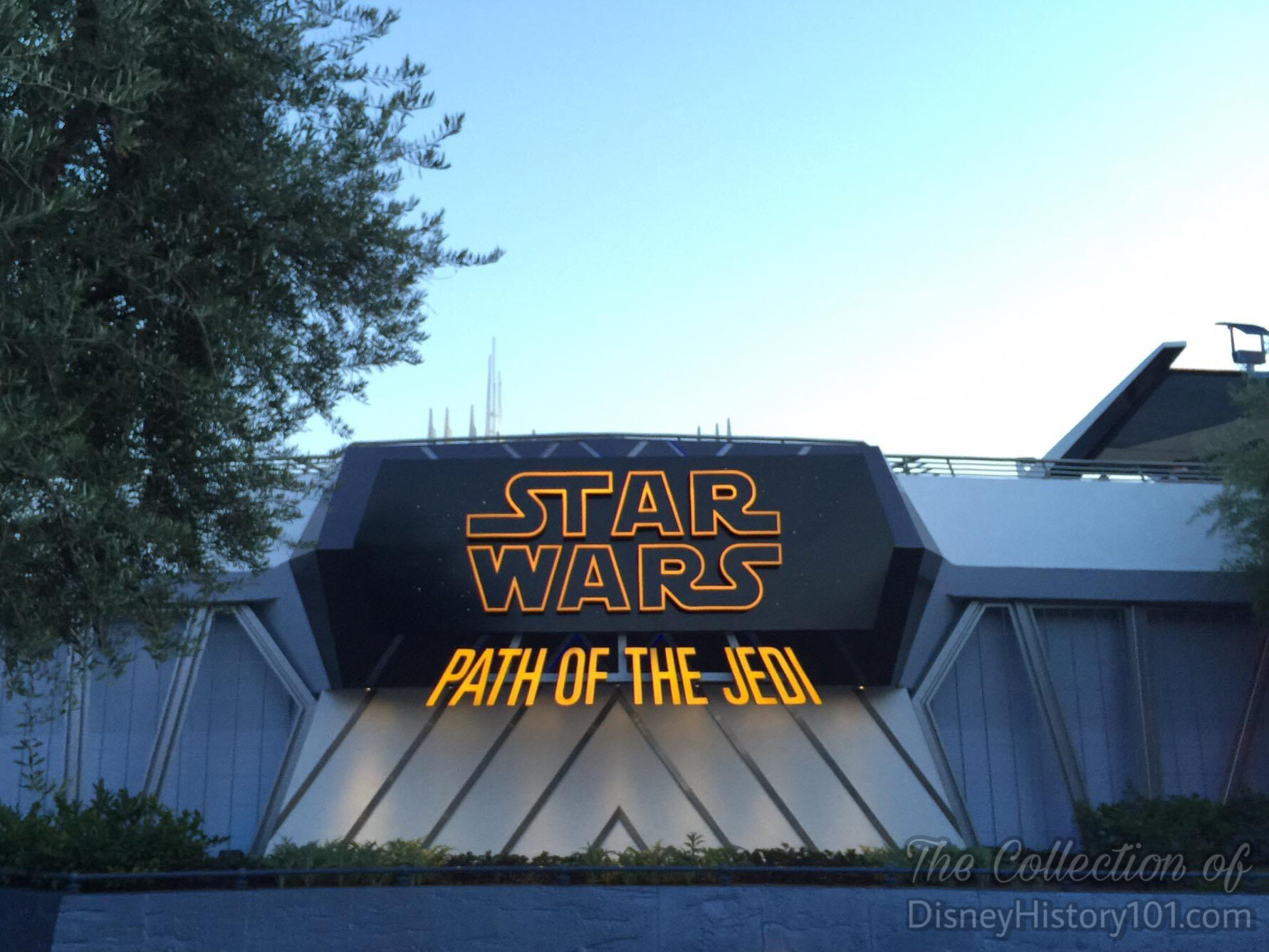
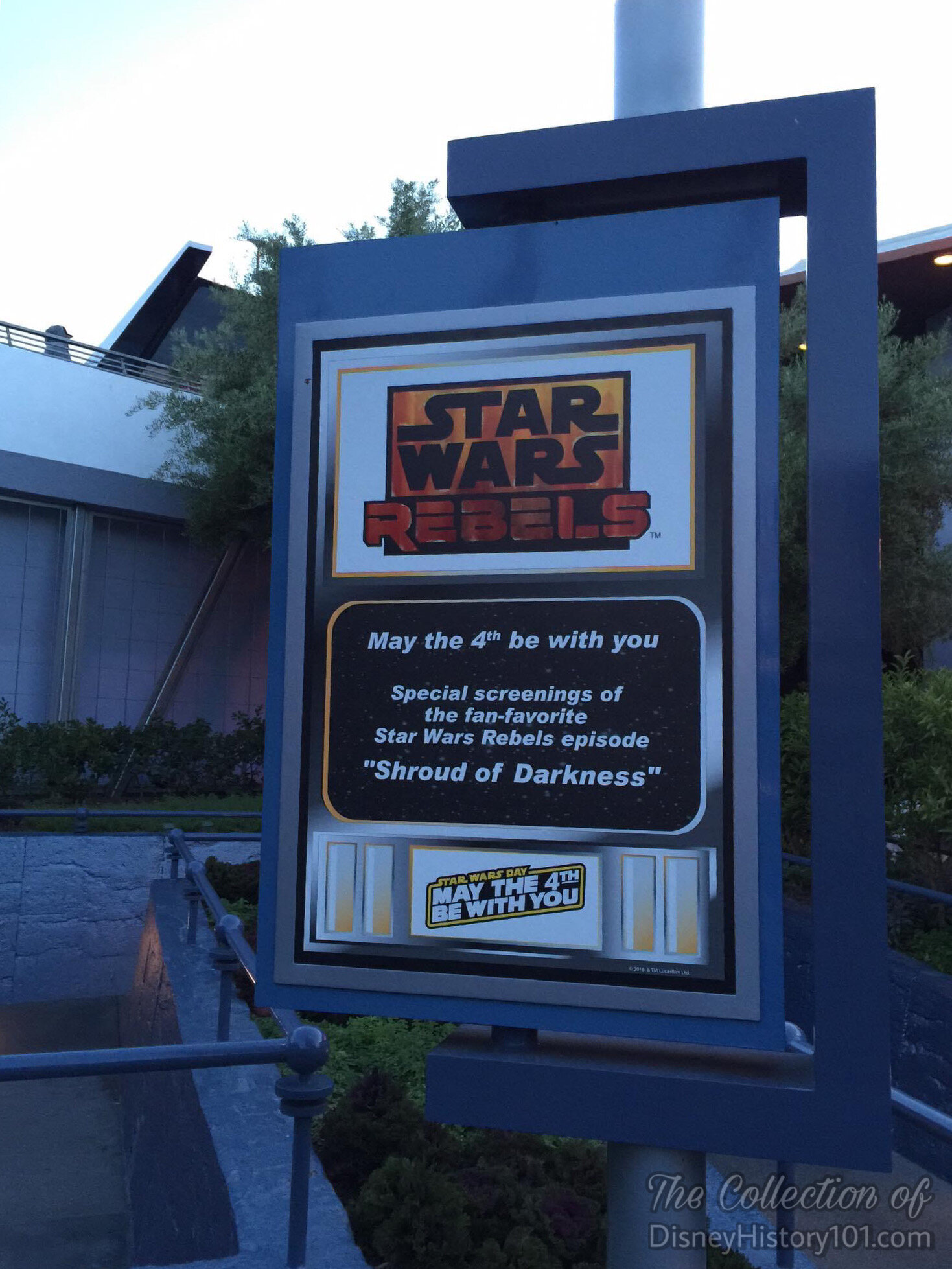
UPJOHN PHARMACY (Upjohn Apothecary) and NEW CENTURY WATCHES & CLOCKS
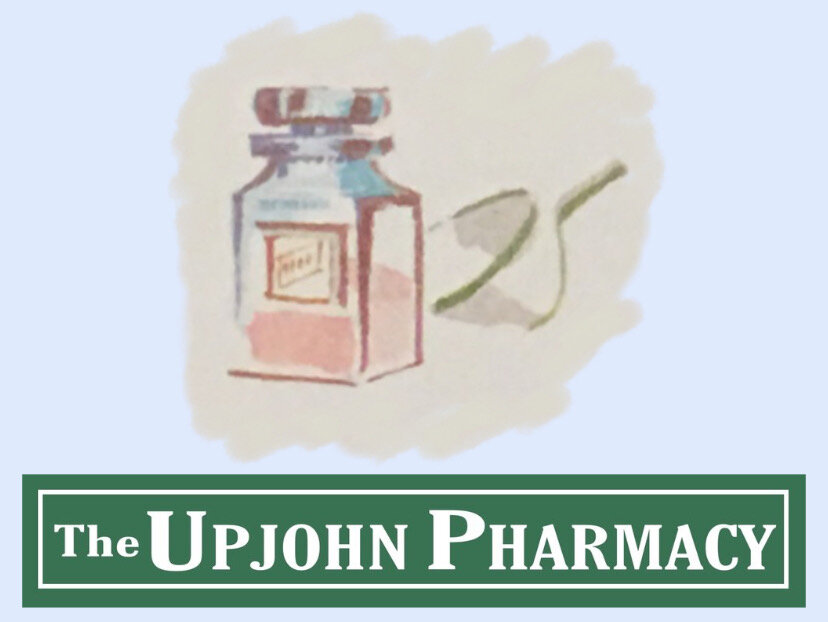
Regarding most any project pursued, Walt Disney once said: “We have always tried to be guided by the basic idea that, in the discovery of knowledge, there is great entertainment as, conversely, in all good entertainment there is always some grain of wisdom, humanity, or enlightenment to be gained.” While fewer current Disneyland attractions embody the spirit of those words, the story was far different in the beginning. Back then, “Disneyland is a place to have fun… and with the fun it is a place where you can learn,” according to “Disneyland, U.S.A.” (published 1958, for potential Participants).
According to The Disneyland Story (September 3, 1954) : “You find yourself in a Civic Center or Town Square at the turn of the century, any time from 1890 to 1910. Here you will see…the Drug Store.” As we make our way by the barbershop quartet, and ice cream parlor, we arrive at another turn-of-the-century small town “staple” - Upjohn Pharmacy! This was Main Street U.S.A.’s original corner drug store, and an opening day Disneyland attraction at that. As guests entered the 1,480 square foot exhibit, they could experience real licensed pharmacists (in period specific clothing), performing turn-of-the-century tasks amidst medical and surgical Antiques of a Victorian-era apothecary shop.
All of this, was sponsored by the Upjohn Company - one of the United States’ turn-of-the-century business pioneers, “old reliable firms, which have been in business fifty years or more. Here they can show how they started and reproduce their first place of business.” [Disneyland Prospectus, 1954]
By July 1, 1954, George Whitney of Disneyland, Inc. directed Amusements, with Ron Miller overseeing analysis, philosophy, capacities, planning, operator training, and amusement procurement. By July 1, 1954, Russel Tippett of Disneyland Inc. Advertising oversaw Exhibitor’s Space Sales and Lease Agreements. Disneyland Participant Corporate Sponsors were carefully selected. High quality, long term corporate sponsors would provide incremental income that enabled Disneyland to enhance its show and attractions, offset some operating expenses, and capitalize on marketing opportunities.
It was intended that Disneyland feature “the turn-of-the-century shops and stores - the photographer's shop, ice-cream parlor, penny arcade, bakery, drug store, music shop, butcher, grocer, many of which are sponsored by outstanding American companies whose names are familiar ‘household words.’” As Walt described to Bob Thomas (of Associated Press), “some industries will have exhibits, but all of them must be in keeping with the era.”
“Disneyland is unique in that some of the world's foremost creative artists and architects control all design at Disneyland.“ While the facade was designed by architect Earle G. Kaltenbach and Hollywood art director Gabe Scognamillio, the interior of the shop was first designed by artists of WED Enterprises, Inc., but re-designed (by architect Will Burton) to resemble a typical apothecary shop circa 1886. Upjohn had two main publicly accessible rooms - the Victorian era drugstore apothecary shop (filled with more than 1,000 medical antiques), and a contemporary-style Modern Room (which showcased Upjohn Company’s drug manufacturing processes). Here, Disneyland guests could look back to the roots of the Upjohn Pill and Granule Company, as well as the future of the Upjohn Company of Kalamazoo, Michigan!
“Architectural Designs by Lessees”
Disneyland, Inc. printed materials for Lessees detailing specifications for architectural designs of exhibit spaces. These were revised by March 16, 1955 and issued to Lessees.
All of the interior architectural drawings were done by competent registered architects or an approved display house of the lessee's choice. All of the designs submitted by the lessee's architect, whether for buildings or construction of interiors in DISNEYLAND, were approved as to the theme and general plan of DISNEYLAND as established by WED Enterprises, Inc.
Three sets of preliminary drawings were furnished DISNEYLAND, Inc. as soon as possible after signing of the lease. Two sets were retained by DISNEYLAND and one set was returned to the lessee’s architect with any revisions noted thereon and stamped “APPROVAL TO PROCEED TO FINAL DESIGN.” This stamp when properly signed and dated constituted the lessee’s authority to proceed with the final drawings.
The Lessees revised their final drawings to incorporate any revisions noted on the approved preliminary drawings, and submitted three sets of the revised drawings to DISNEYLAND. One set was returned to the lessee’s architect and any revisions noted thereon are to be incorporated on the original drawings. When the lessee had incorporated the final revisions on the drawings, two sets of transparent ozalids were forwarded to DISNEYLAND for approval. DISNEYLAND would stamp both sets “FINAL DESIGN APPROVED” and “LESSEE’S CONTRACT DRAWINGS”, and return one set to the lessee who could then release drawings for bid and/or construction.
“Construction”
“When the giant earth-moving undertaking was completed, the building crews took over. Soon, the rat-tat-tat of riveters was shattering the air, and sparks were flying from welders’ torches as the steel frameworks, capable of withstanding the ravages of time and the elements rose above the newly formed ground. While carpenters hammered and masons laid row upon row of brick and stone and mortar, the permanent buildings began to take shape and form,” according to “The Disneyland Story” published 1955. One of the first buildings to be constructed was the Main Street Opera House, which was used as the Mill. Here, the woodwork of Disneyland was generated - from the functional to the aesthetic! Approximately three and one-half million board feet of lumber went into the Park’s construction. Much of the wood was processed here by McNeil Construction (which formerly constructed Walt Disney Studio sound stages in 1947 and 1953), and under the direction of George Mills Sr. (the Prime General Contractor and Mill Foreman). Then, under the direction of Joe Fowler (Construction Supervisor), as well as Charles Alexander and Ray Conway (Construction Field Supervisors), the lumber was soon fashioned into the framing belonging to the very first buildings constructed at Disneyland - primarily the Main Street Complexes (on each side of the street).
All fixtures were placed in their correct motif and many light fixtures of Disneyland were authentic antiques.
F.M. Franz, manager of operations for MeNeil Construction expressed: "We feel sure there has never been anything built like this in Southern California, or elsewhere in the United States. Many of the items were constructed from artist’s sketches.” Work began on the 11,860 square-foot Main Street Building #300 and its 1,480 square-foot Upjohn Drug Company Building. In constructing the building, a concrete foundation and slab floors were prepared, followed by wood frame construction (while store units would have a combination wood and rigid steel frame). ”The first fabricated steel for the Main Street buildings arrived November 8 and was erected,” according to the narrator of “Disneyland - The Park,” a Disneyland anthology television series excerpt, first aired 1957 and Disneyland LINE (November 22, 1979).
According to inserts published in area newspapers during July of 1955, Disney buildings were roofed by Pioneer Roof & Shingle Company (then located at 608 Mateo Street, Los Angeles, California; 7522 Westminster Avenue, Westminster, California). The roof covering was a variable, dependent on the architectural design.
Newbery Electric Corporation gave electricity to Disneyland. “The electrical installations were supervised by Roy J. Gruendler, manager of Newbery's Orange County district office located at 1335 Santiago Ave, Santa Ana.”
As of June 2, 1955, C.V. Wood Jr. sent an Inter-Office Memorandum to Walt Disney regarding the best estimates that could be obtained at the time regarding the status of individual sections of the Park and Opening Day. C.V. wrote: “Building #307 - Upjohn: The construction of the walls and fixtures will be complete. A lot of the props are here now. We do not know if this is all there is to come and if not, if it will all be here for opening… Electric Signs: All are in work - with the exception of the shoe store and the Bank of America, all will be completed.”
The building (as each on Main Street U.S.A.) possessed complete fire sprinkling systems. By June 30, 1955, related Disneyland Site Work Fire Protection Utilities Plot Plans were prepared for Disneyland Inc., by J.E. Thomasson of WED Enterprises Inc.

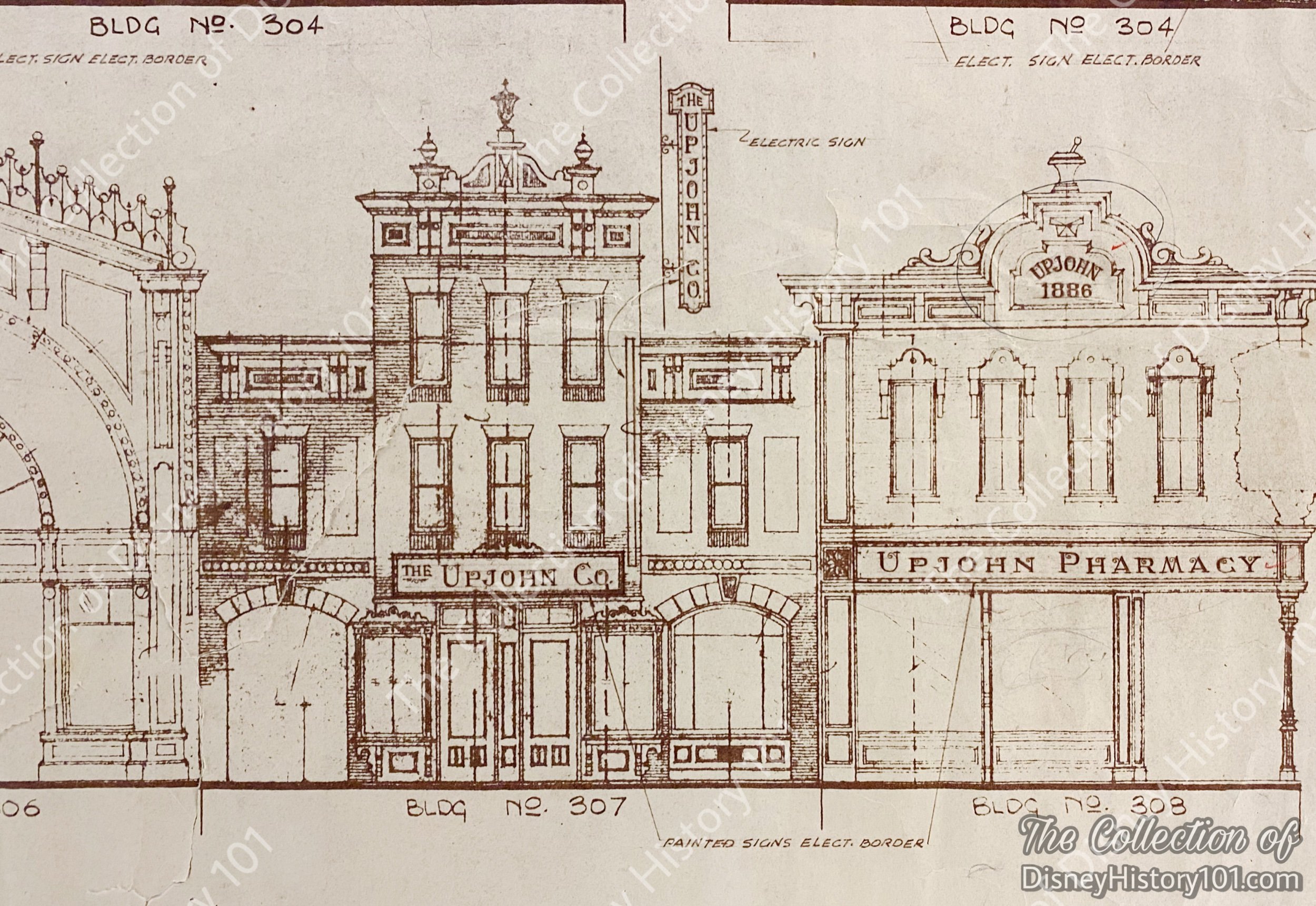
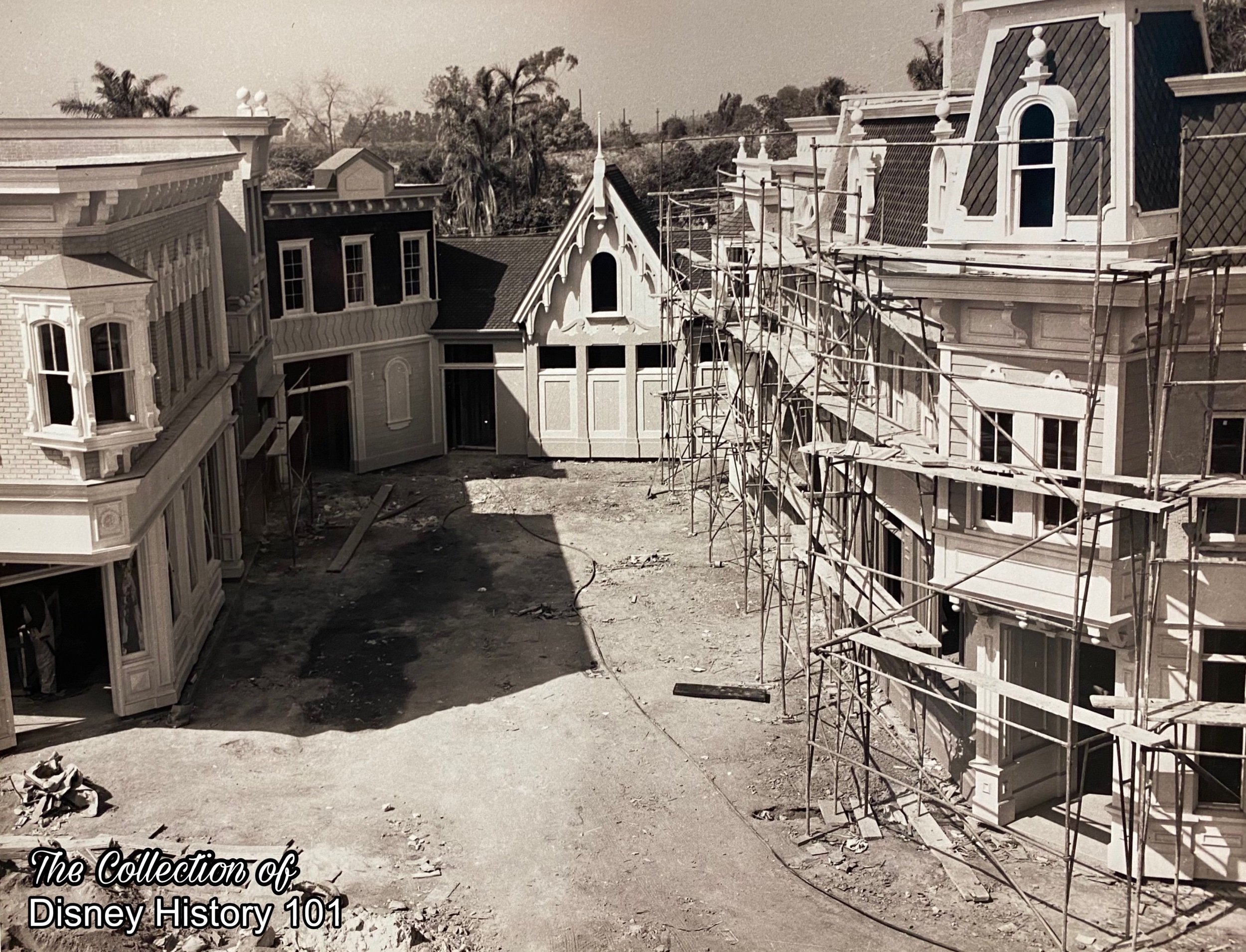

According to The Disneyland Story (September 3, 1954) : “You find yourself in a Civic Center or Town Square at the turn of the century, any time from 1890 to 1910. Here you will see…the Drug Store.” As we make our way by the barbershop quartet, and ice cream parlor, we arrive at another turn-of-the-century small town “staple” - Upjohn Pharmacy! This was Main Street U.S.A.’s original corner drug store, and an opening day Disneyland attraction at that. As guests entered, they could experience real licensed pharmacists (in period specific clothing), performing turn-of-the-century tasks in a Victorian-era apothecary shop. Pictured above, you’ll note an early “Vintage View” of Upjohn Pharmacy taken within a month of Disneyland’s opening day. The construction was unfinished, and the iconic mortar and pestle lamp was still not attached above the corner entrance.
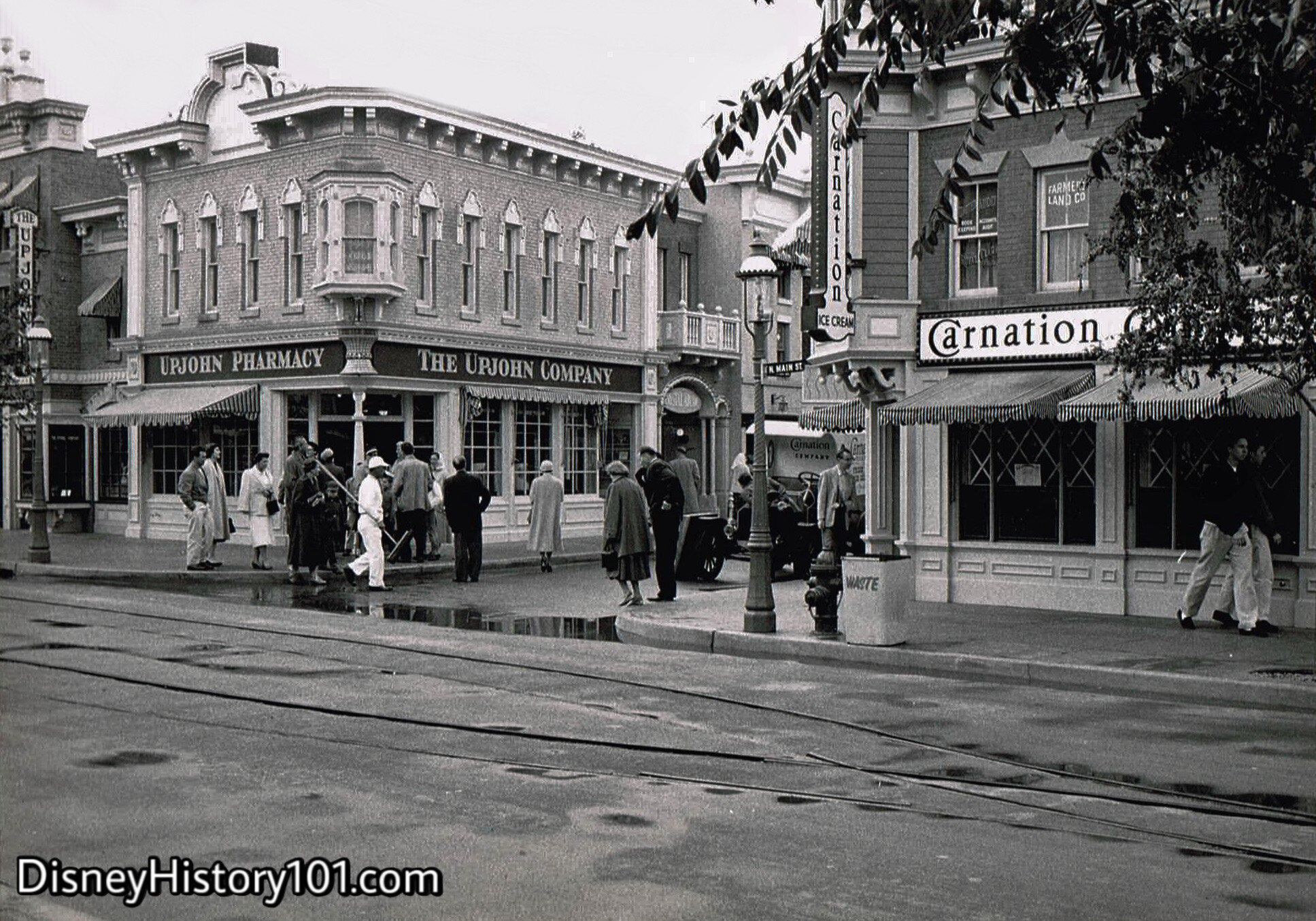
By September of 1955, the mortar and pestle lamp was fixed in place over the corner store’s entrance!
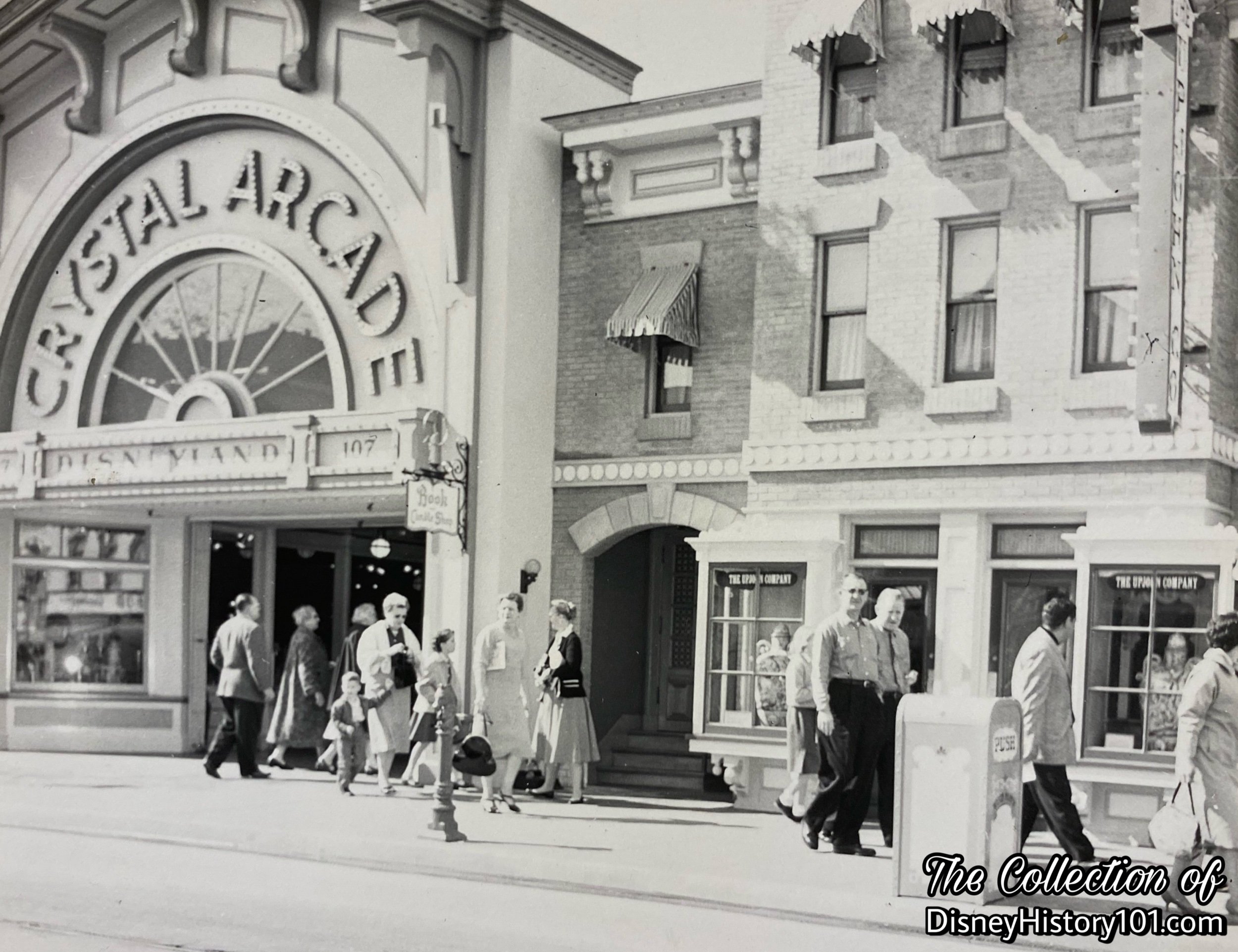
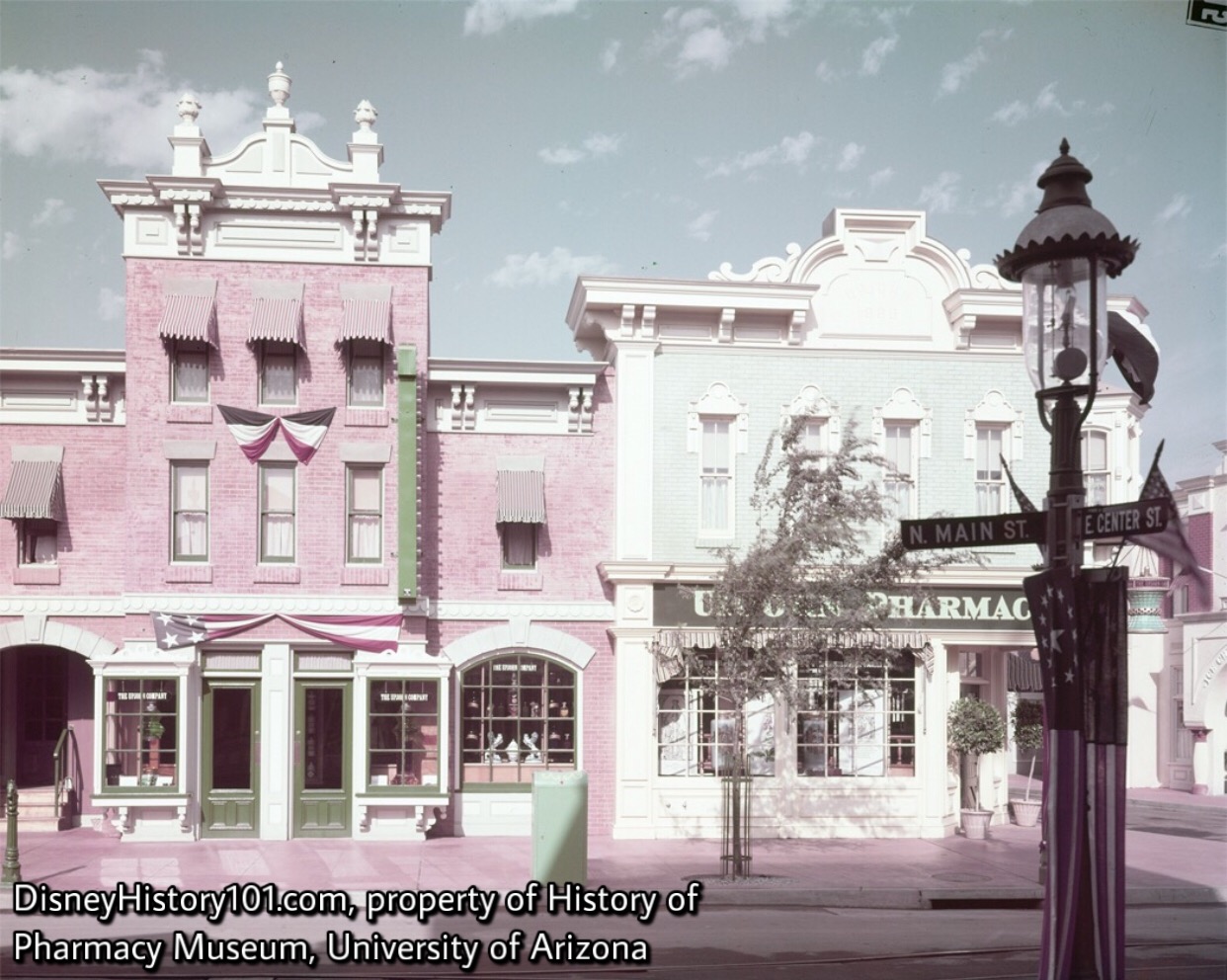
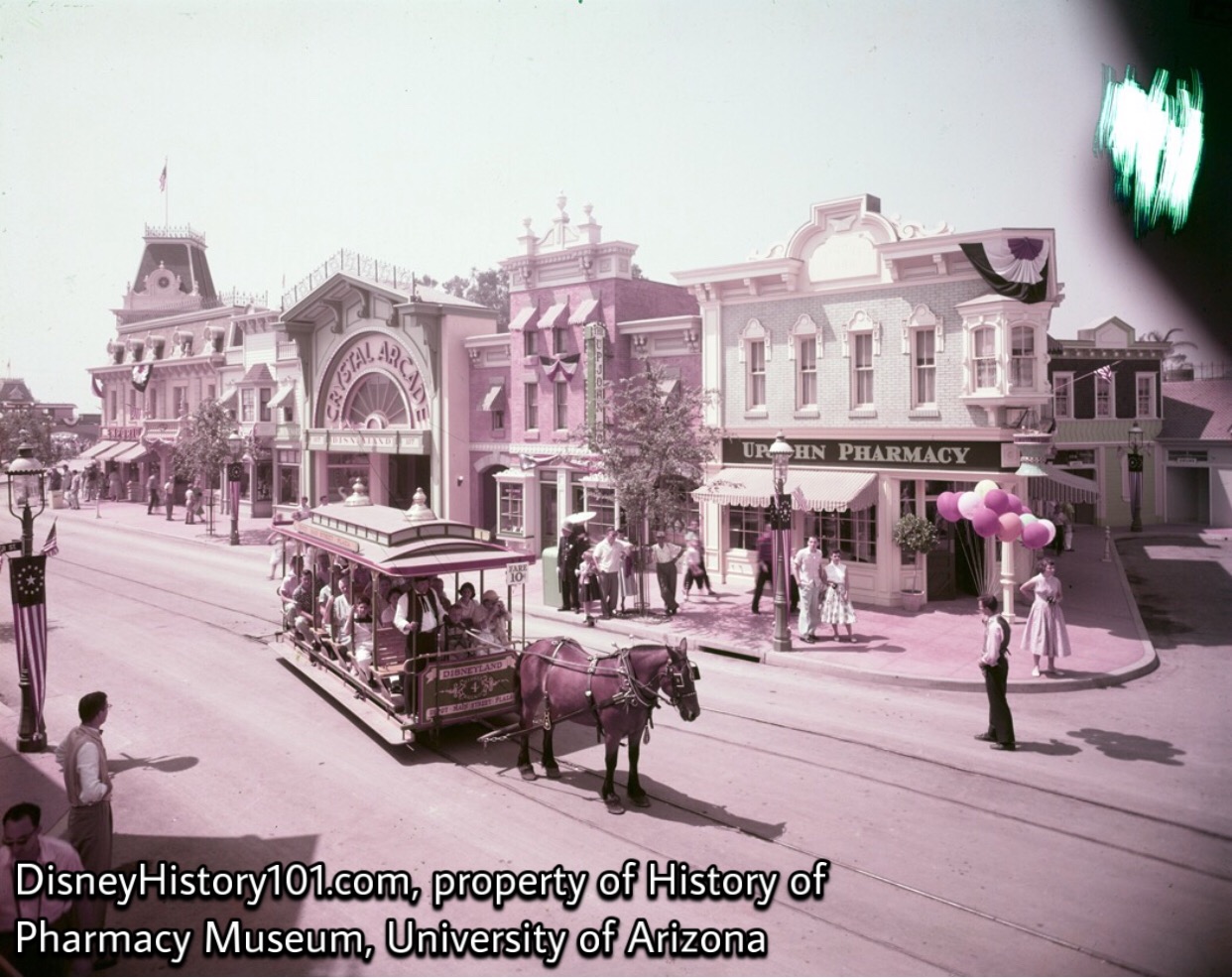
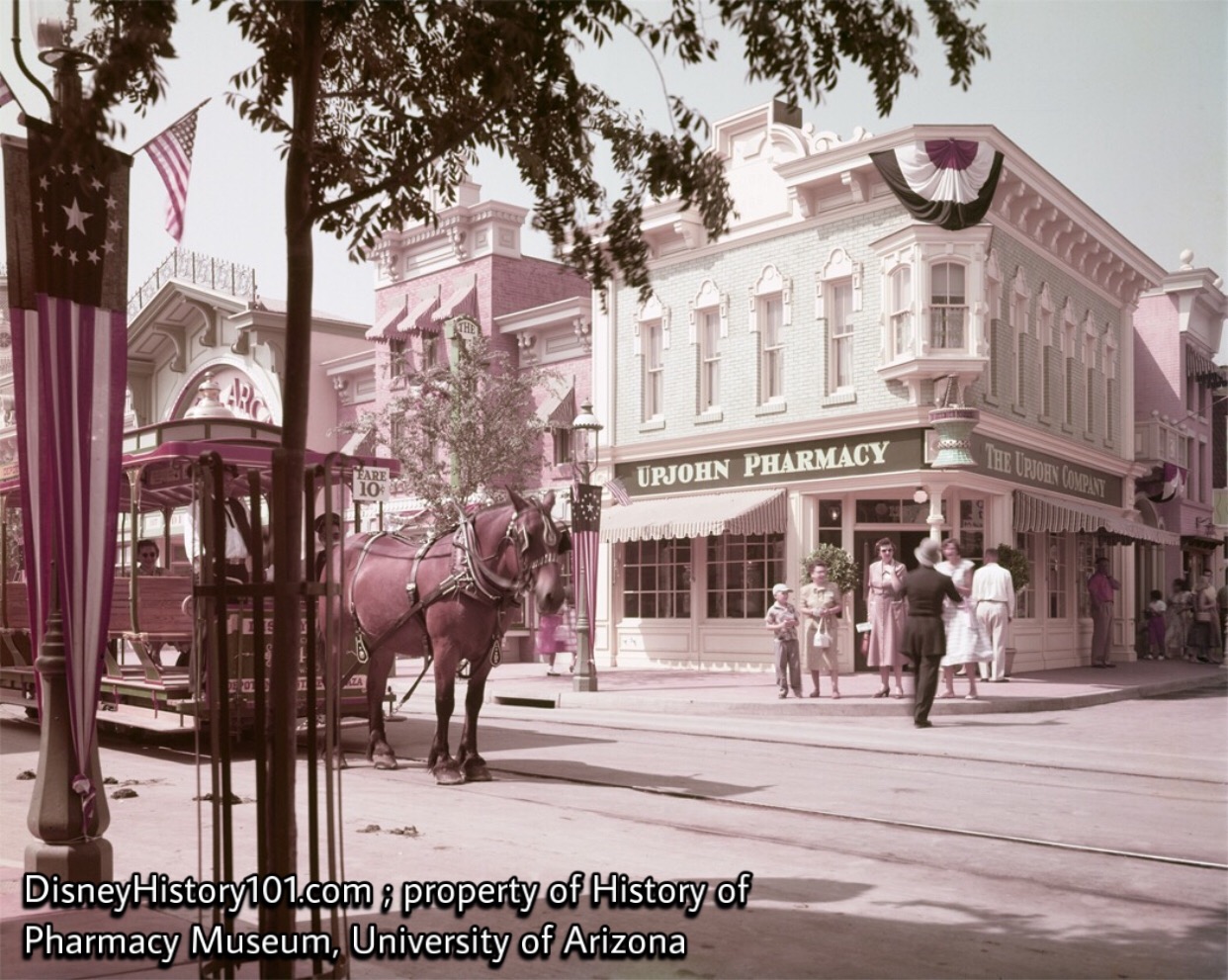
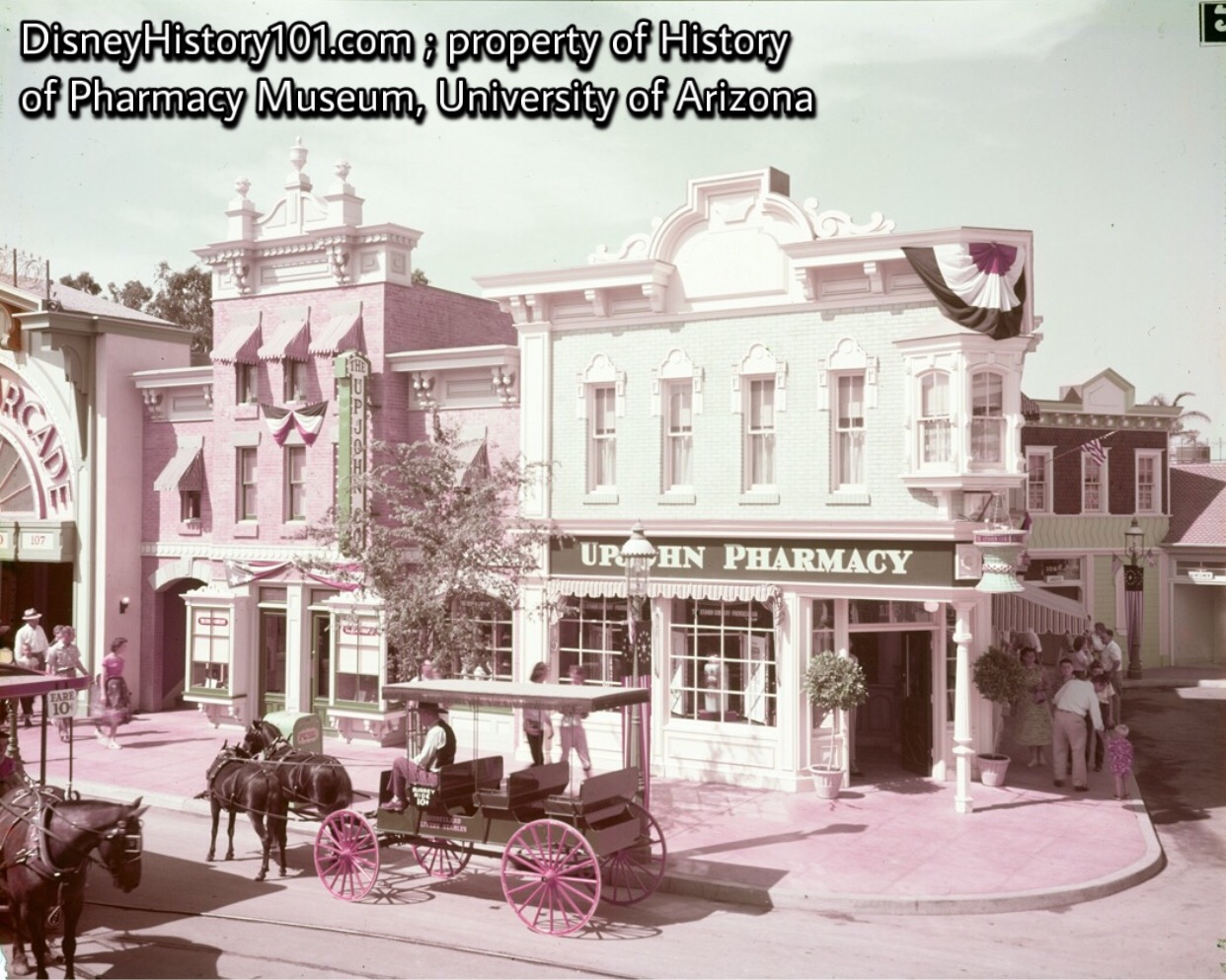
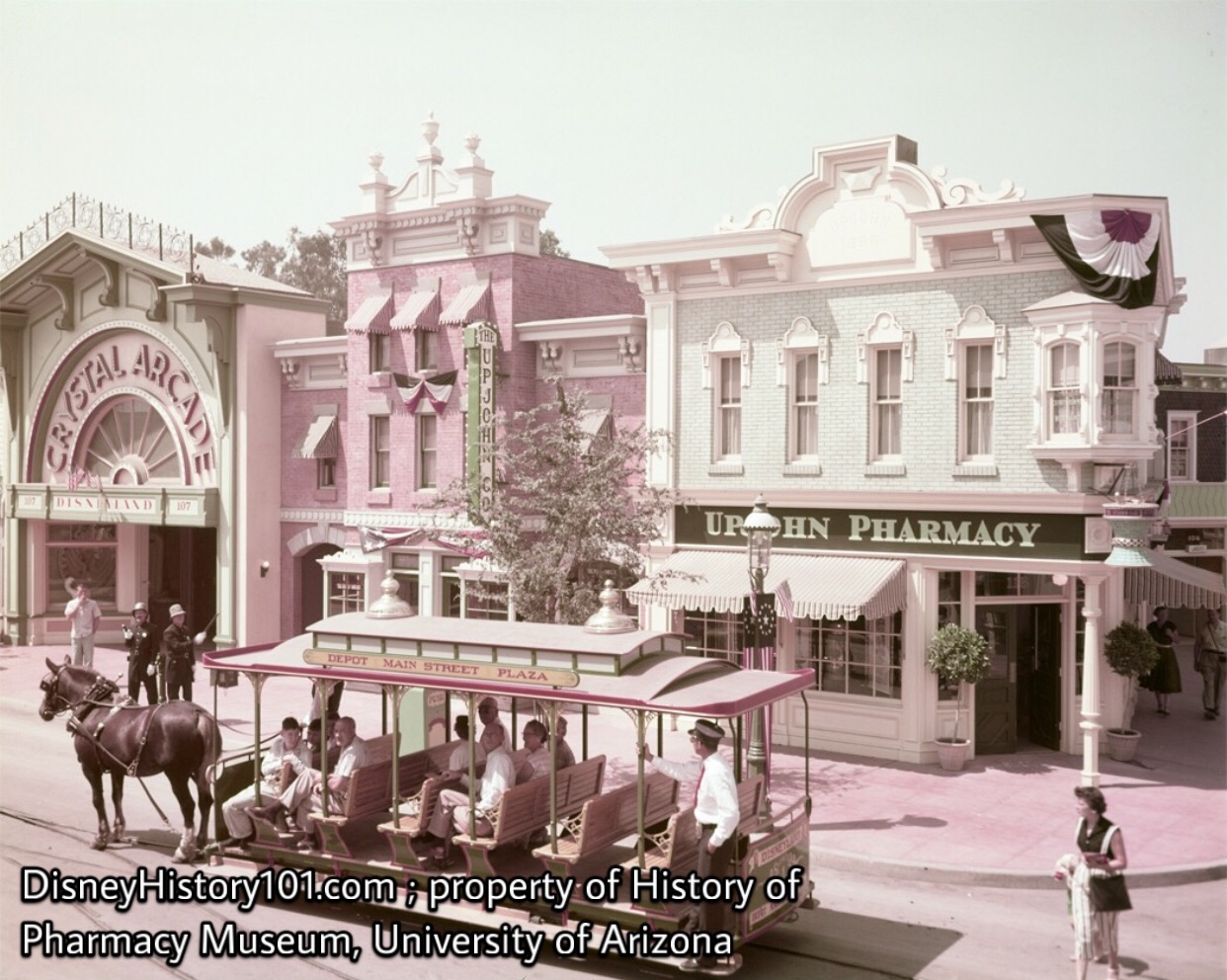
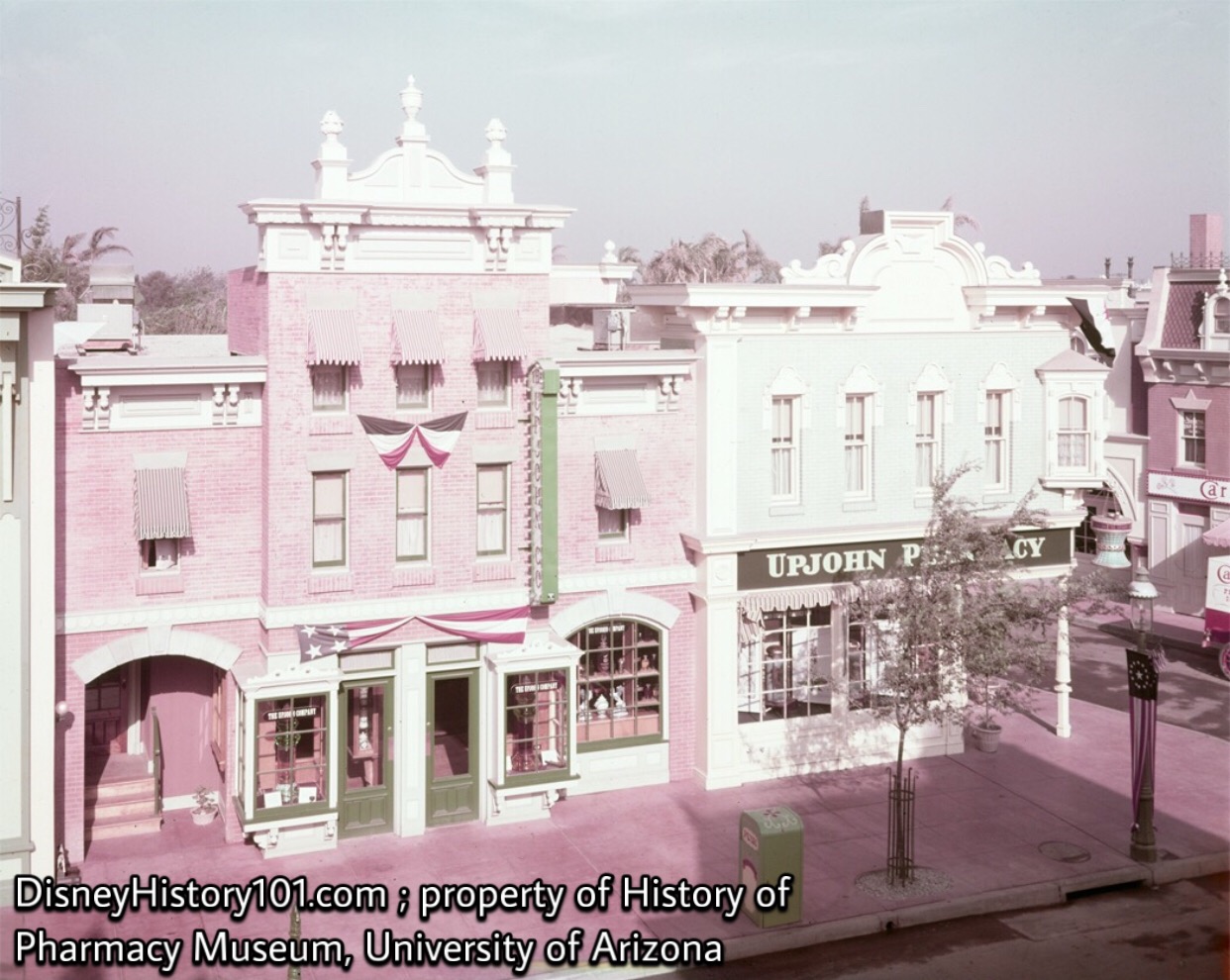
This image was used to produce Disneyland Upjohn Company souvenir postcards that were sold inside the corner store. The caption on the back read, “On the corer of Main Street and Center Streets in Disneyland, the Upjohn Pharmacy comprises one of the most complete museums of pharmaceutical wares, equipment and furnishings.”
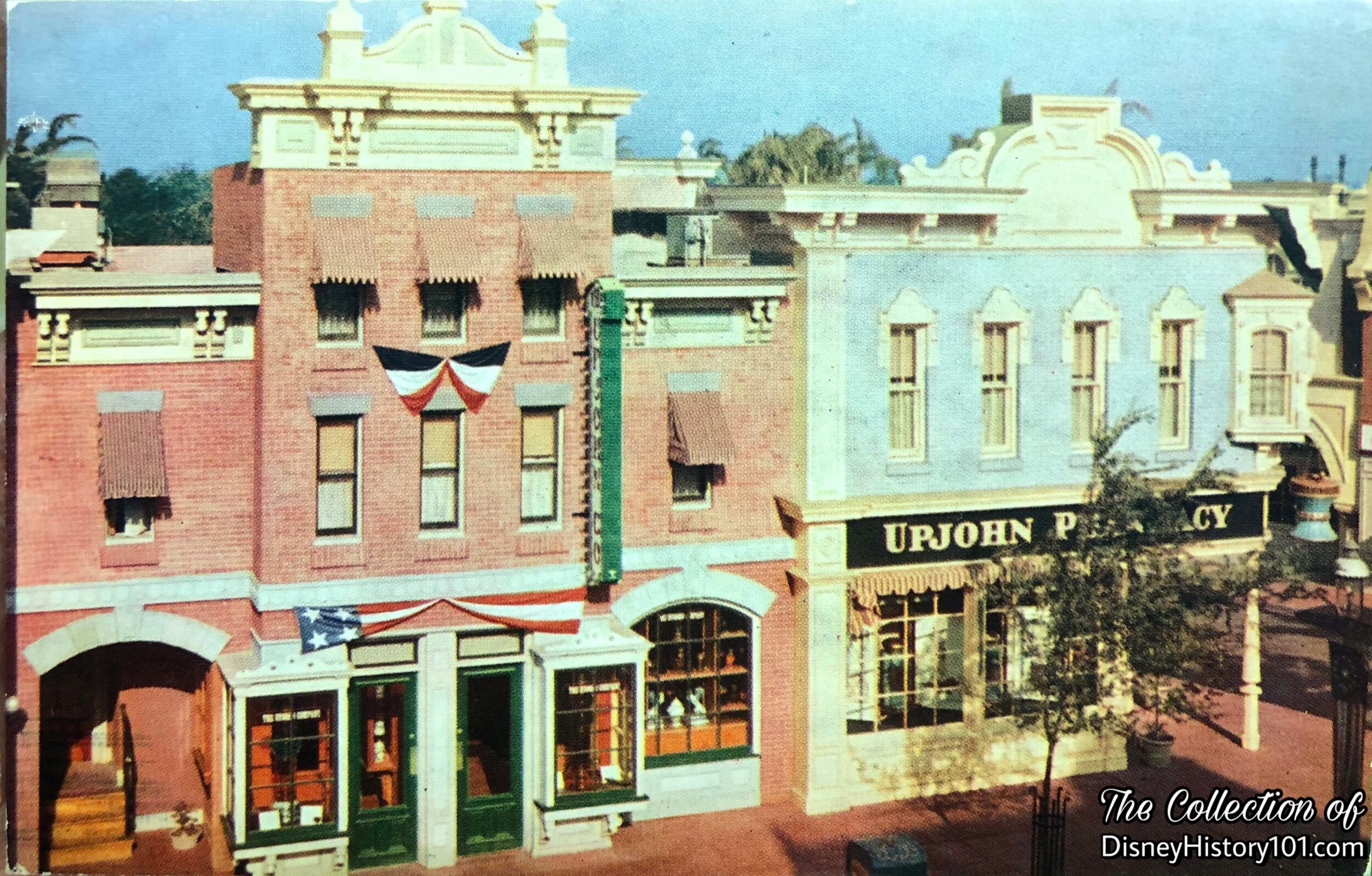
Here, we can see one of the actual postcards sold inside the Upjohn Company during Disneyland’s first fabulous decade.
The corporate synergy was good for a time. Institutional lessee The Up john Company yielded some revenue for Disneyland Inc. - $29,087 for the fiscal year ending September 29, 1957 and $29,600 for the fiscal year ending September 28, 1958.
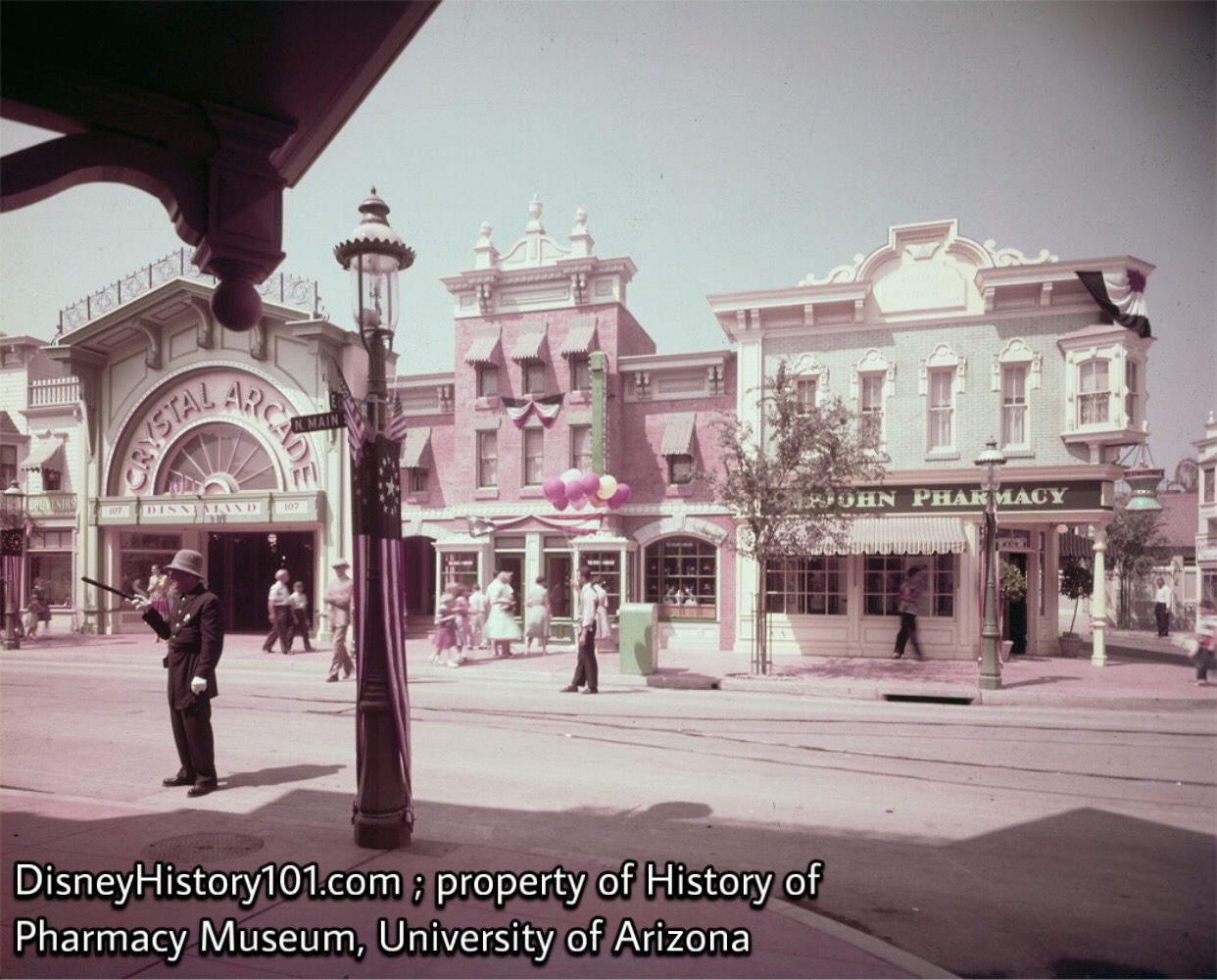
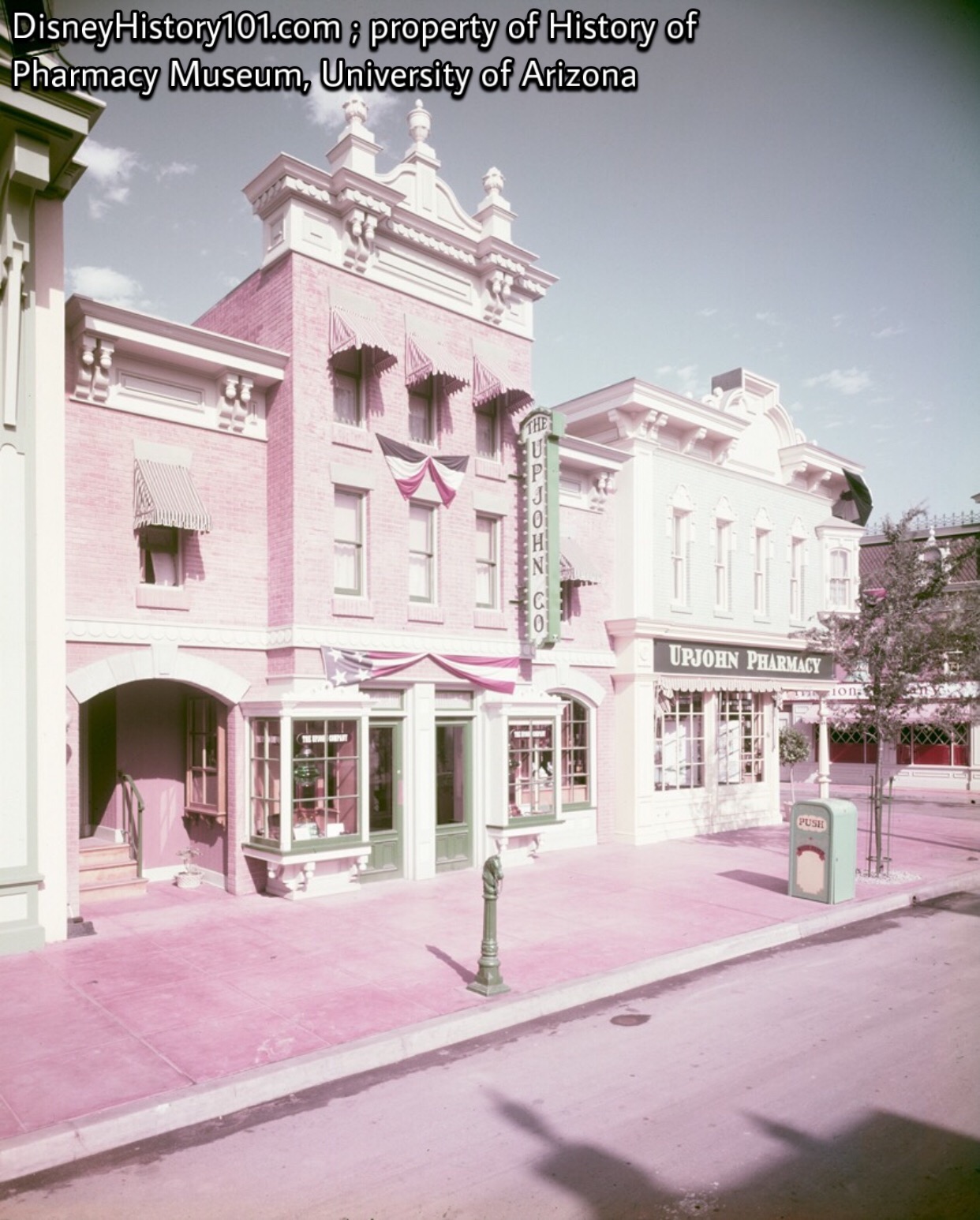
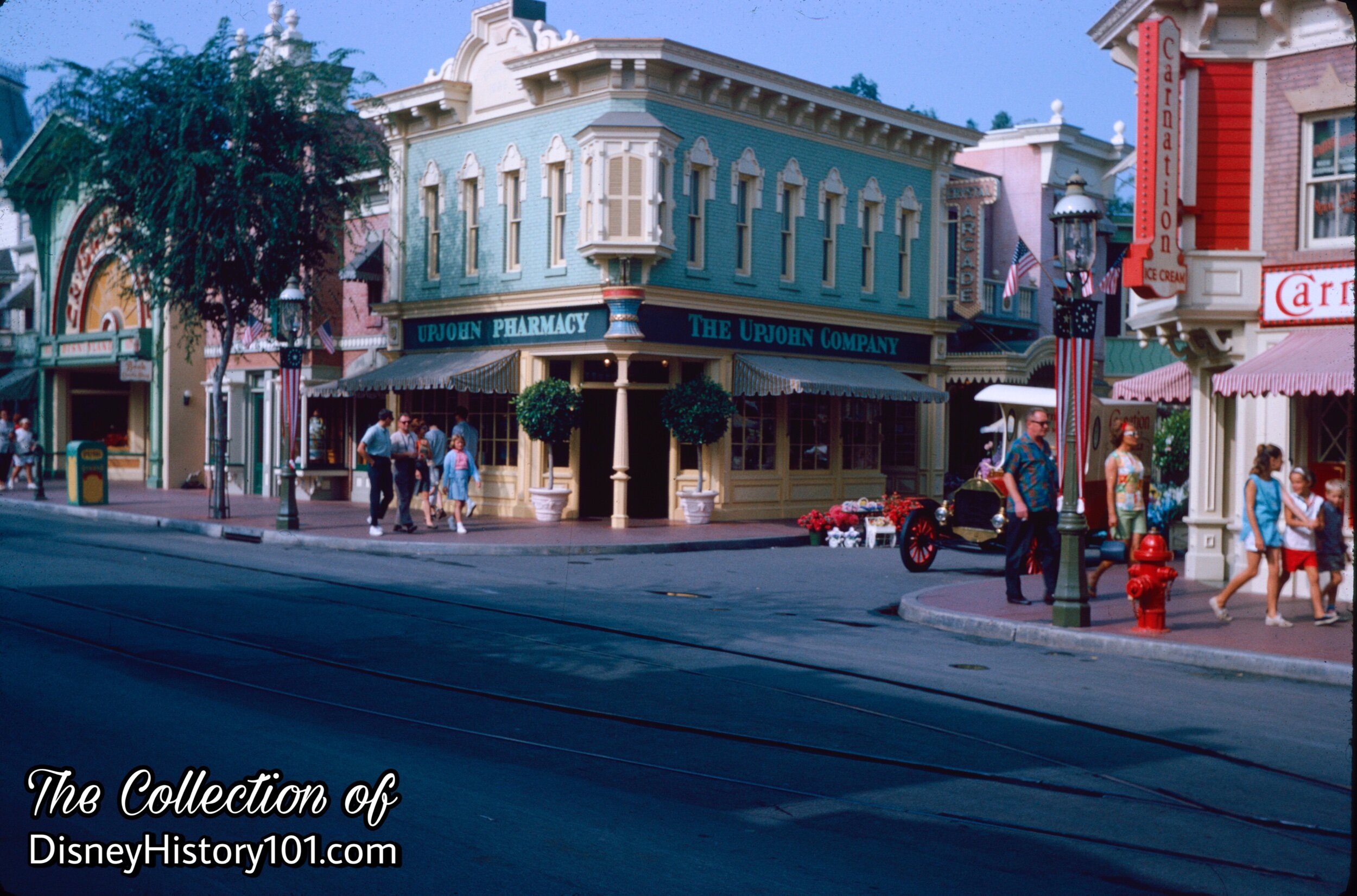
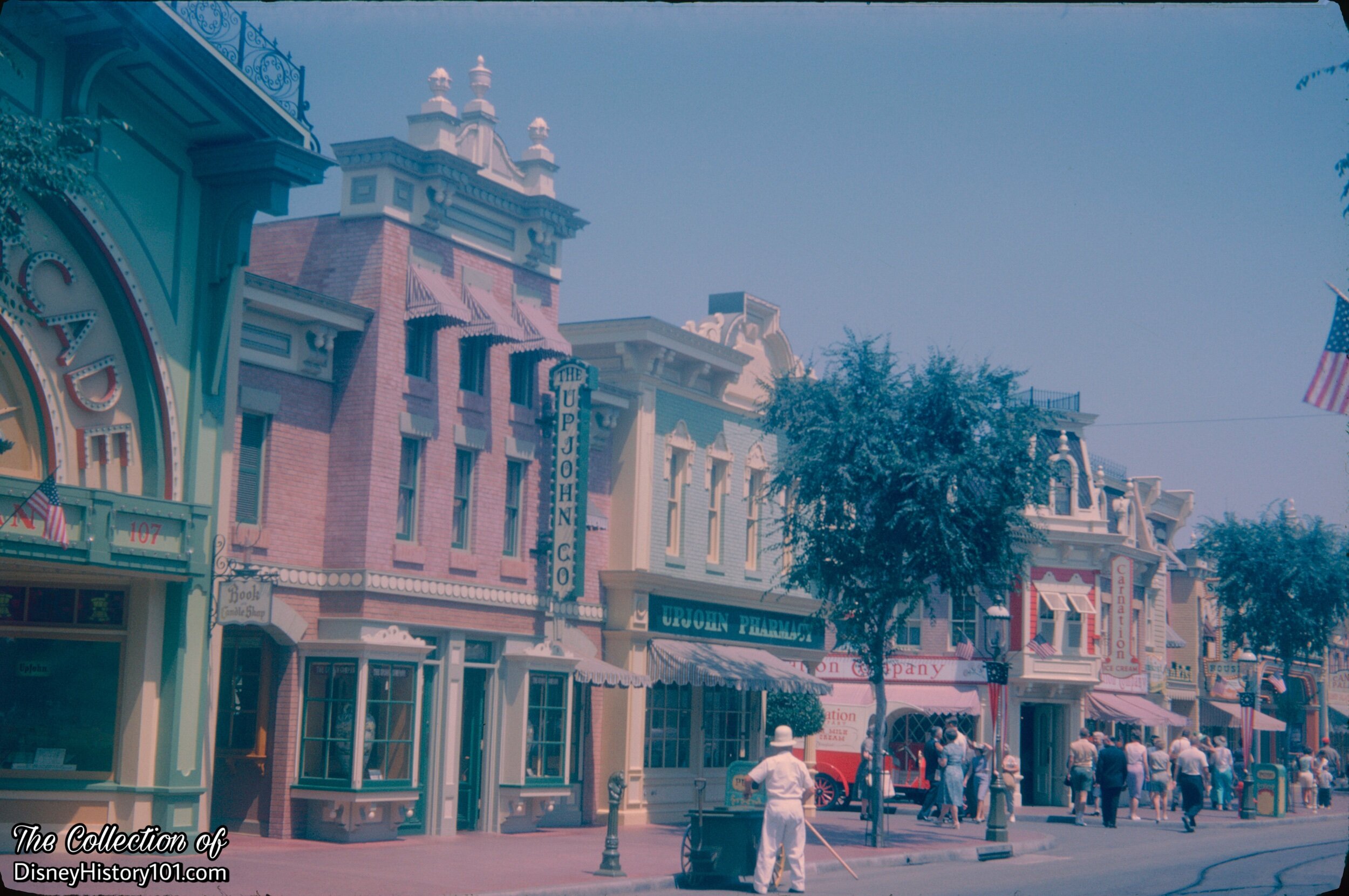
This rare Vintage View gives us a look at just how far the Upjohn Pharmacy’s storefront window displays stretched - clear down to the north side of the Crystal Arcade’s entrance! Notice those stained glass panels above the Crystal Arcade’s entrance, bearing the familiar mortar and pestle logo which hung over the Center Street entrance. The mortar and pestle was ironic, since the Upjohn pills had the reputation of being friable (meaning that they could be crushed “under the thumb”.
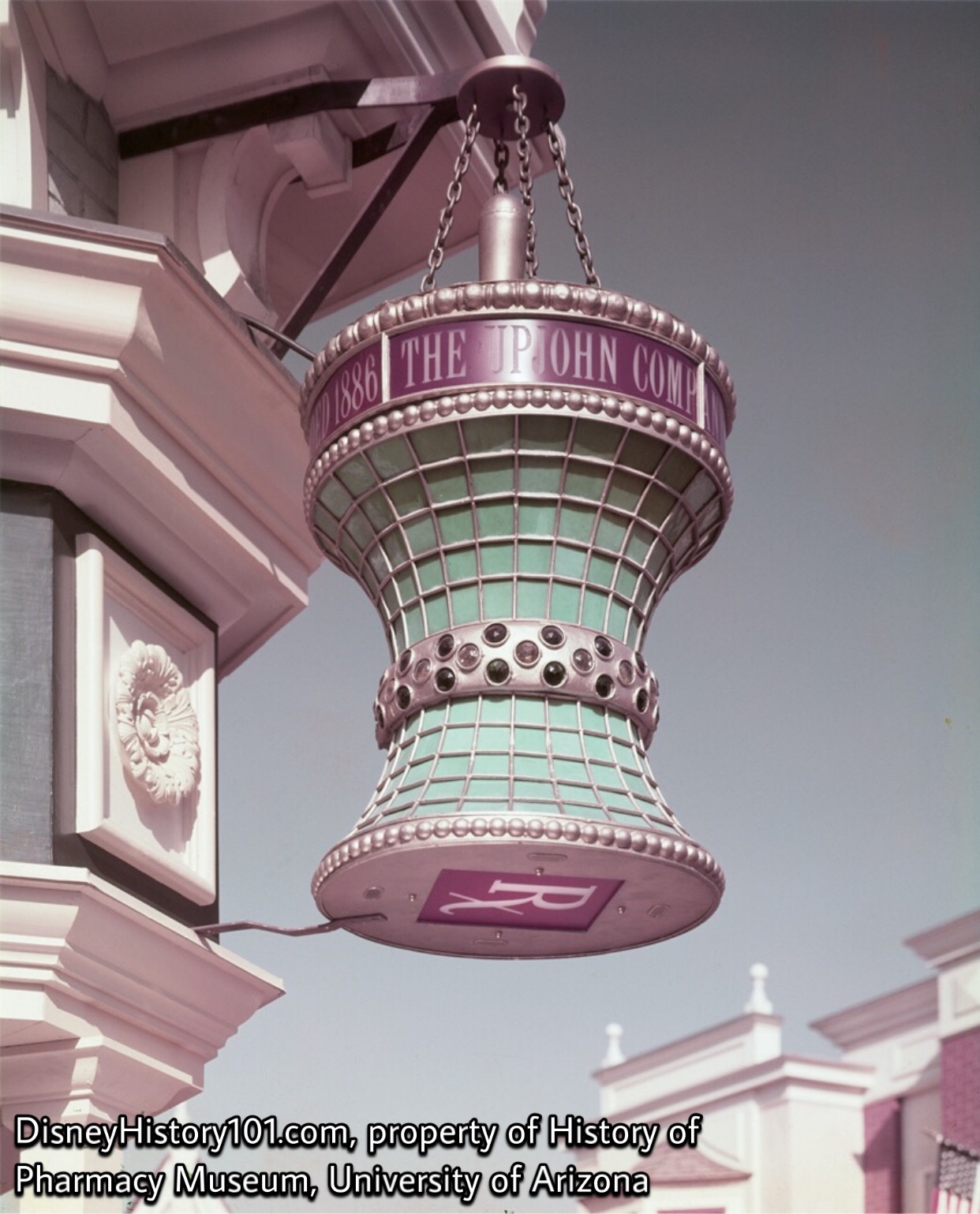
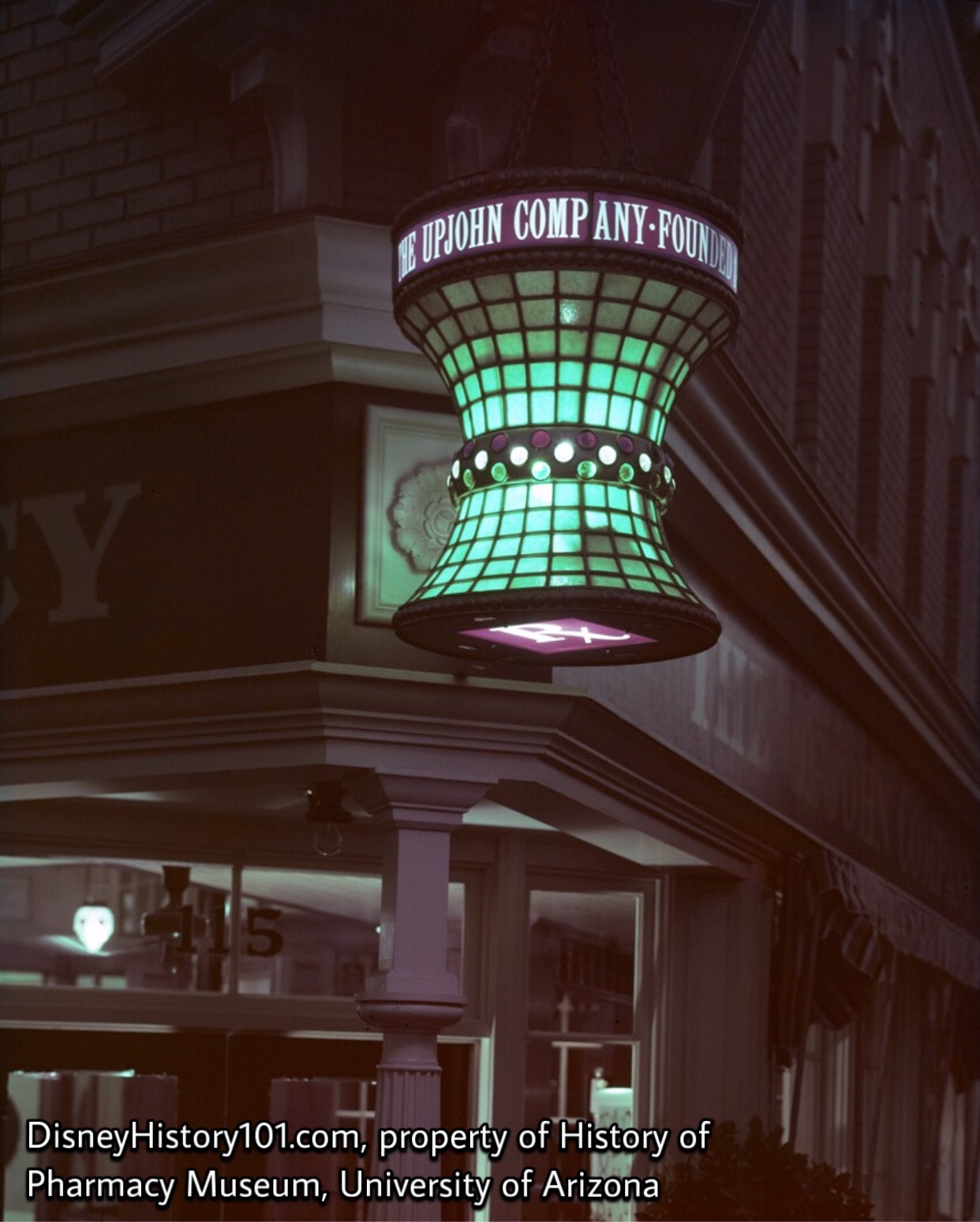
Looking over the Illuminated mortar and pestle lamp, we are reminded of Walt’s own words (in 1962), “I like to be around when the lights come on. It seems like a new kind of magic takes over in Disneyland after dark.”
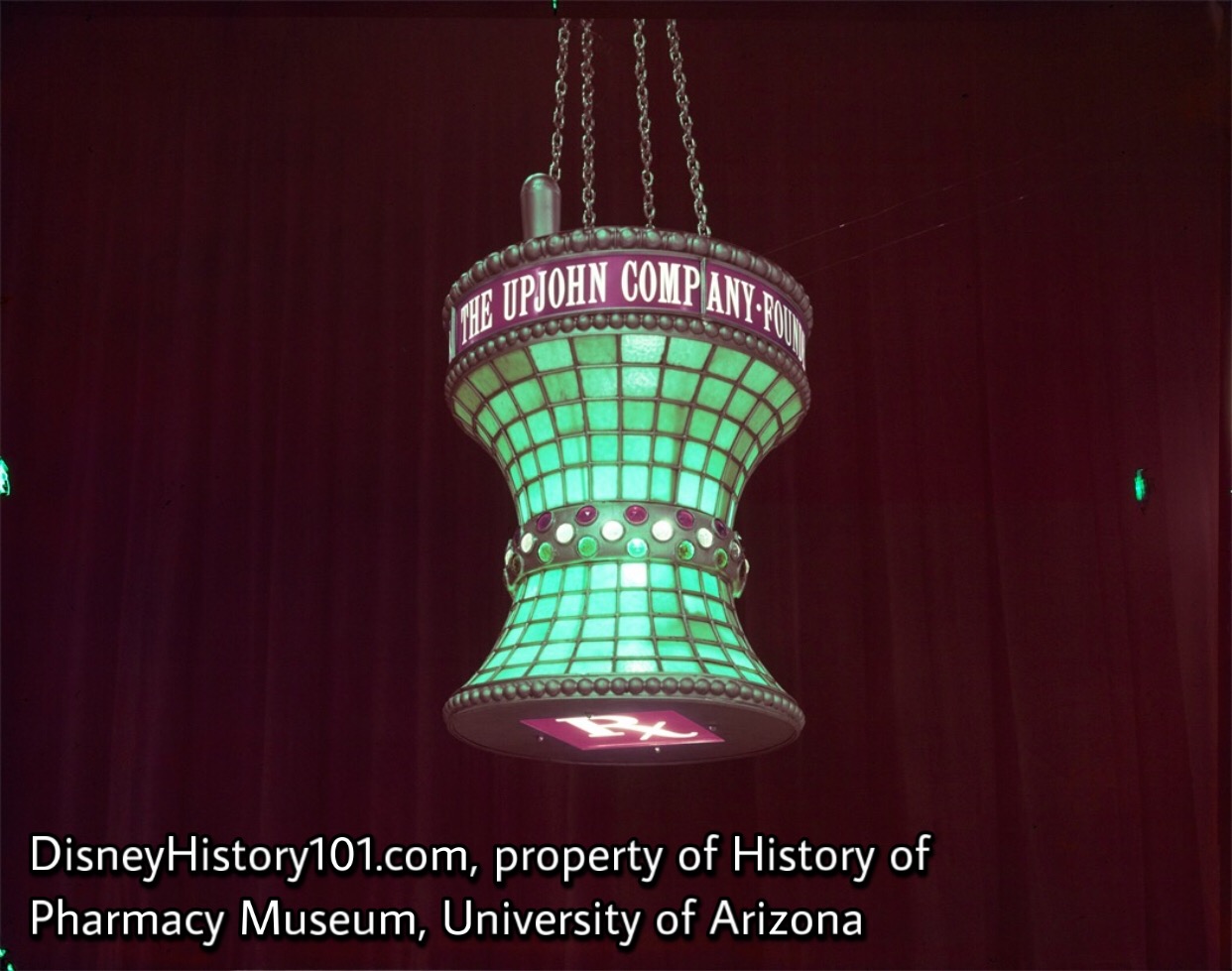

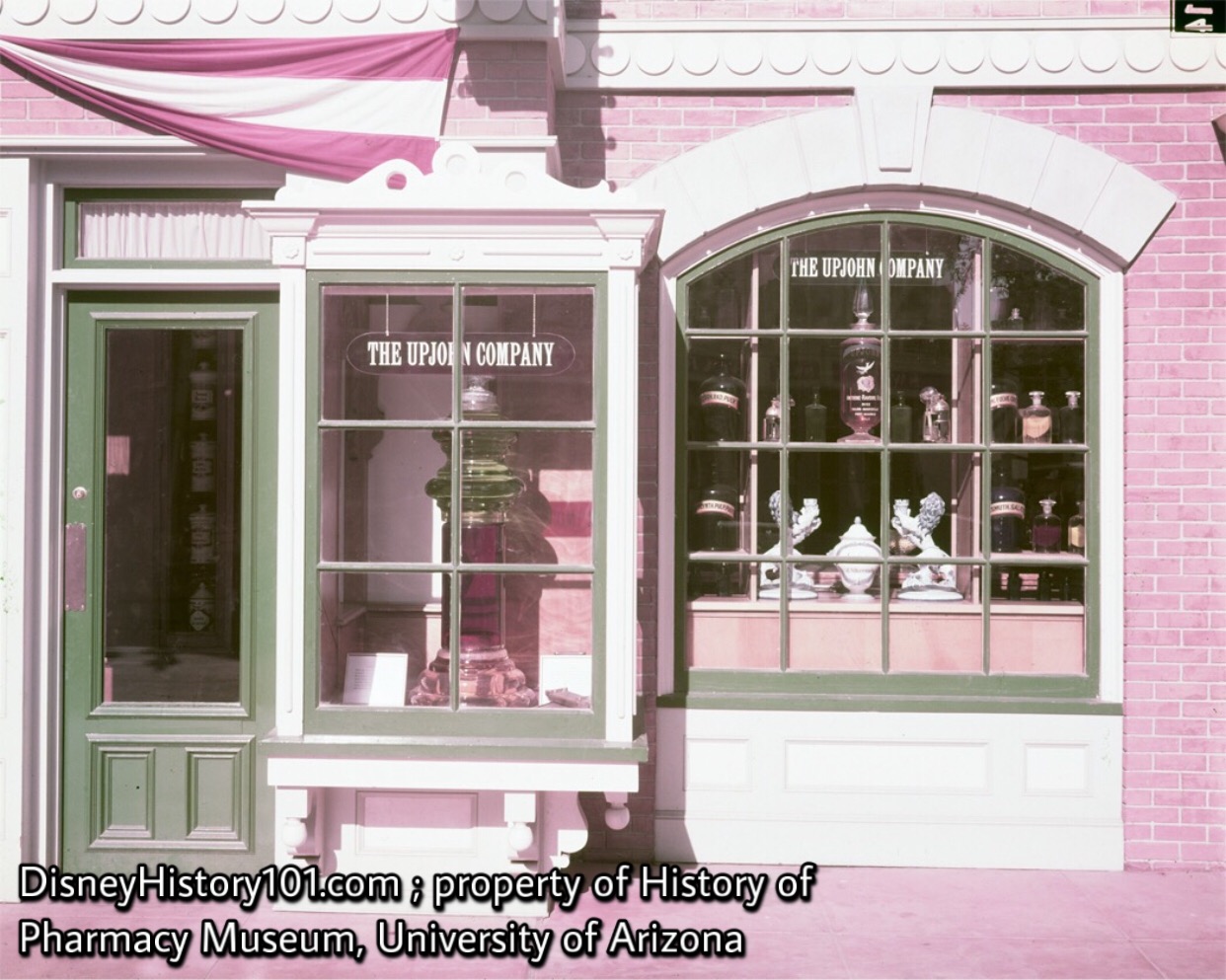
Window displays have always played an important role -communicating to guests the essence of a shop and were designed to invite guests into the store. These may be animated or still and would also include props used for display purposes.
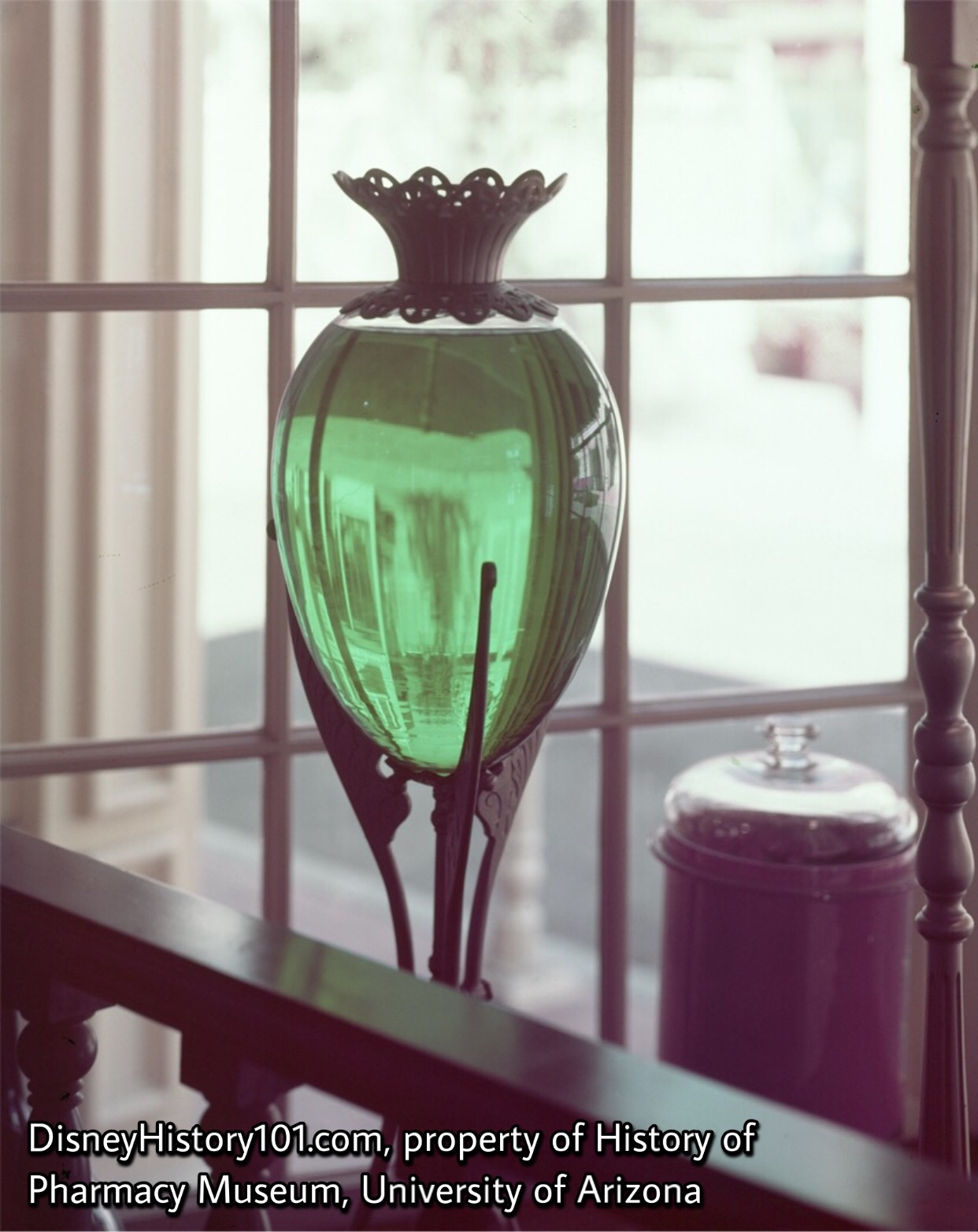
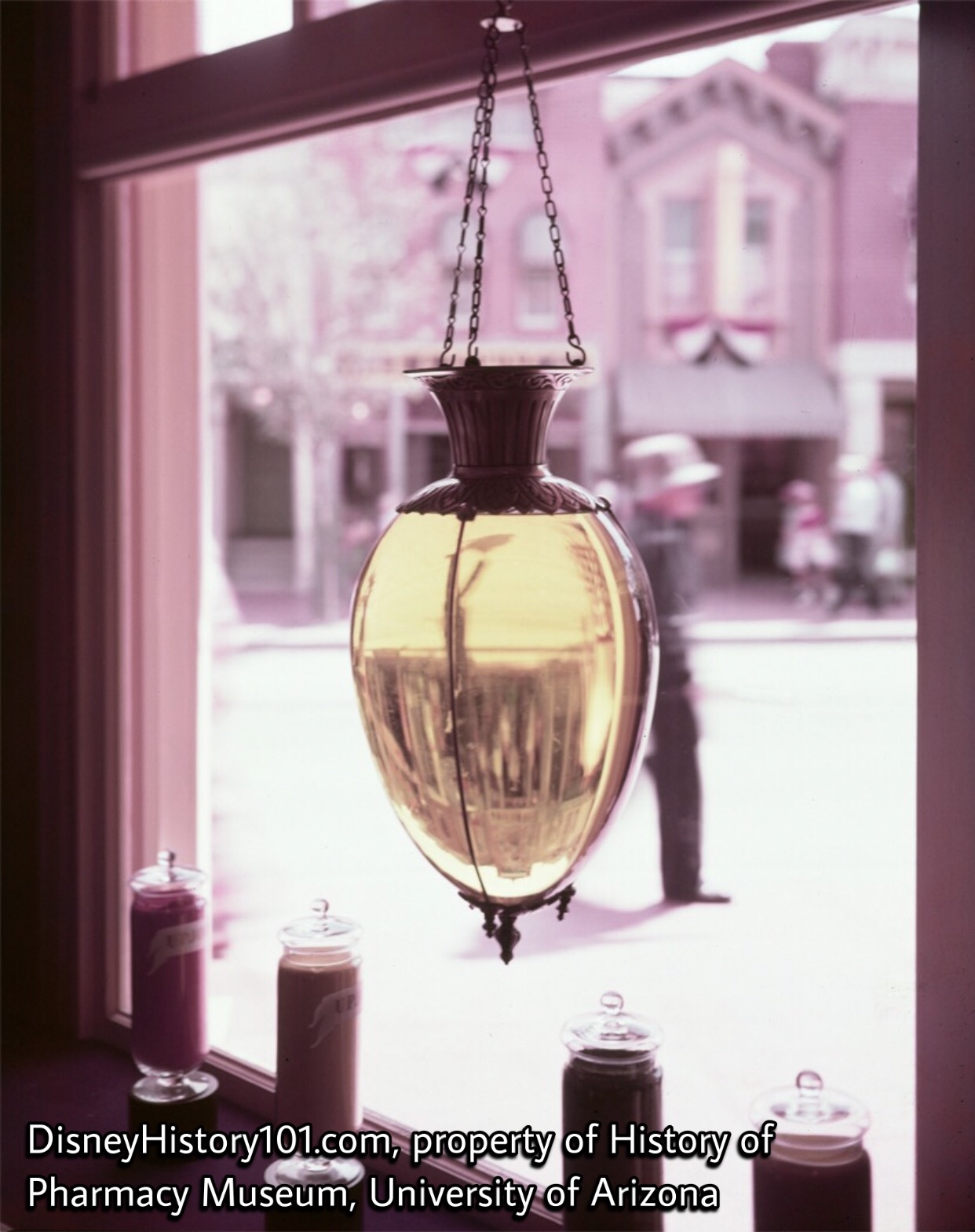
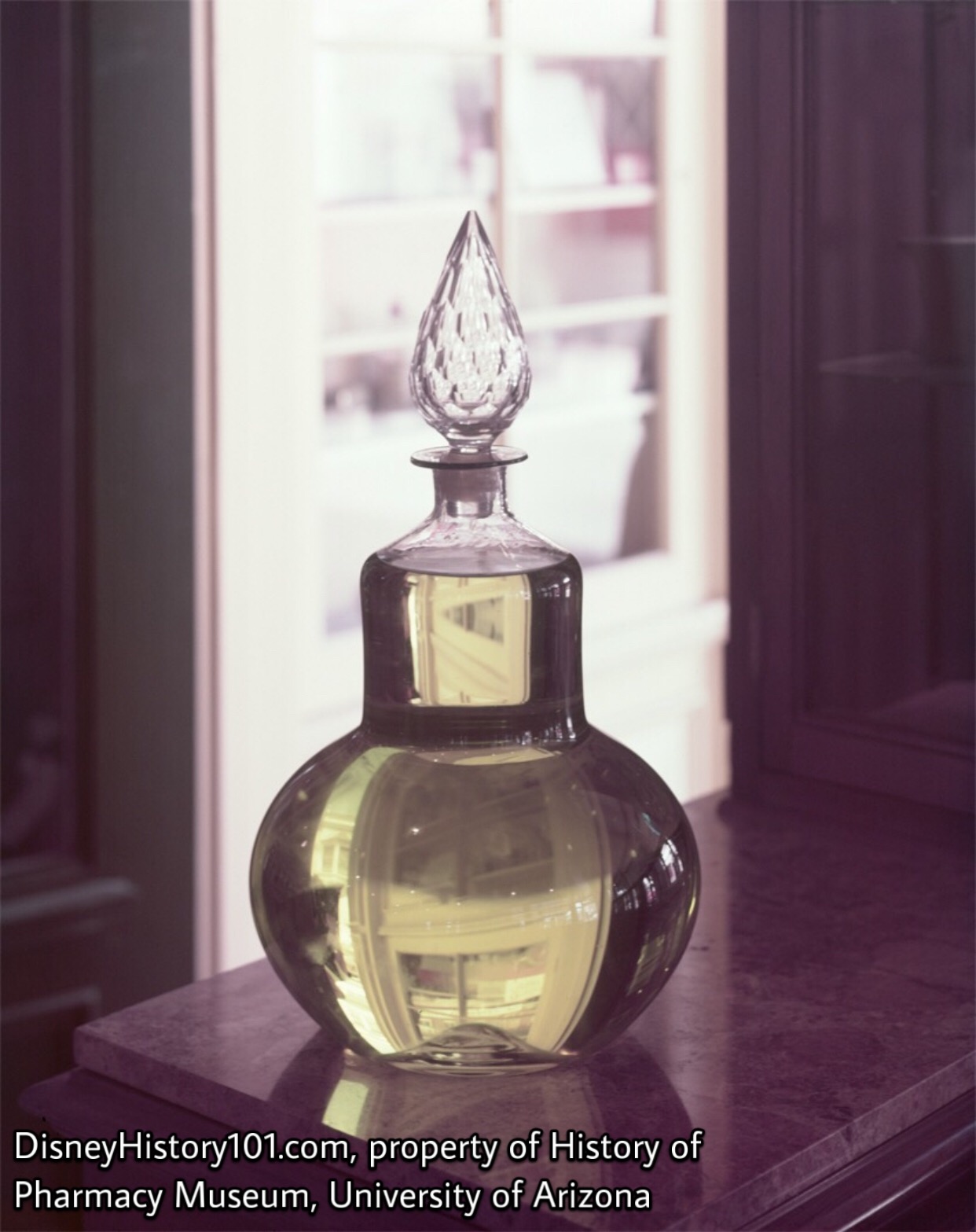
Upjohn Pharmacy housed several show globes. Much like the barber’s pole, show globes were once associated with Apothecaries. There remains a mystery as to the meaning of the globe’s color or the etymology of the name. Some believe that the color may have advertised the health of the local community to travelers passing through town, but there are no sources to confirm or deny that this was the case.
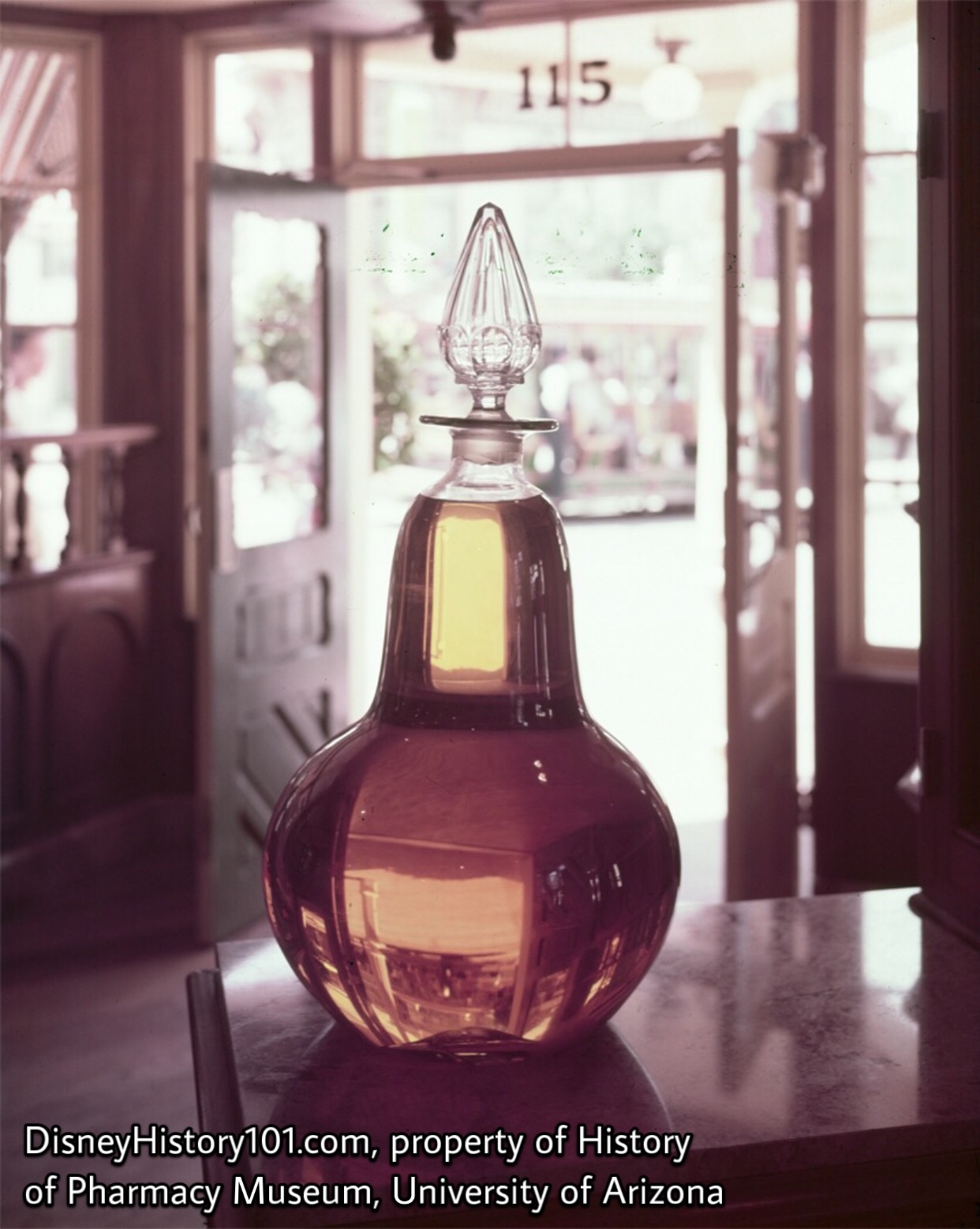
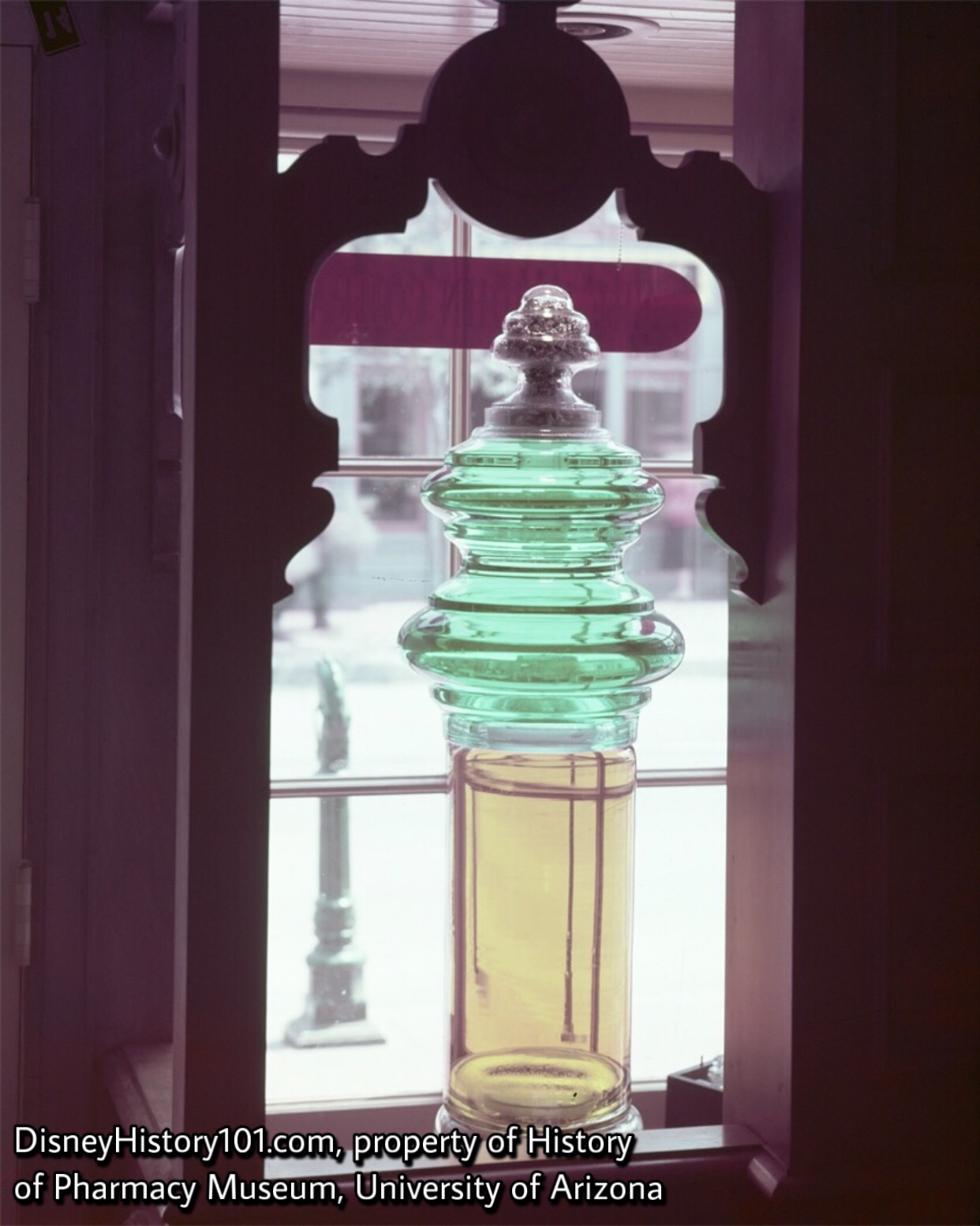
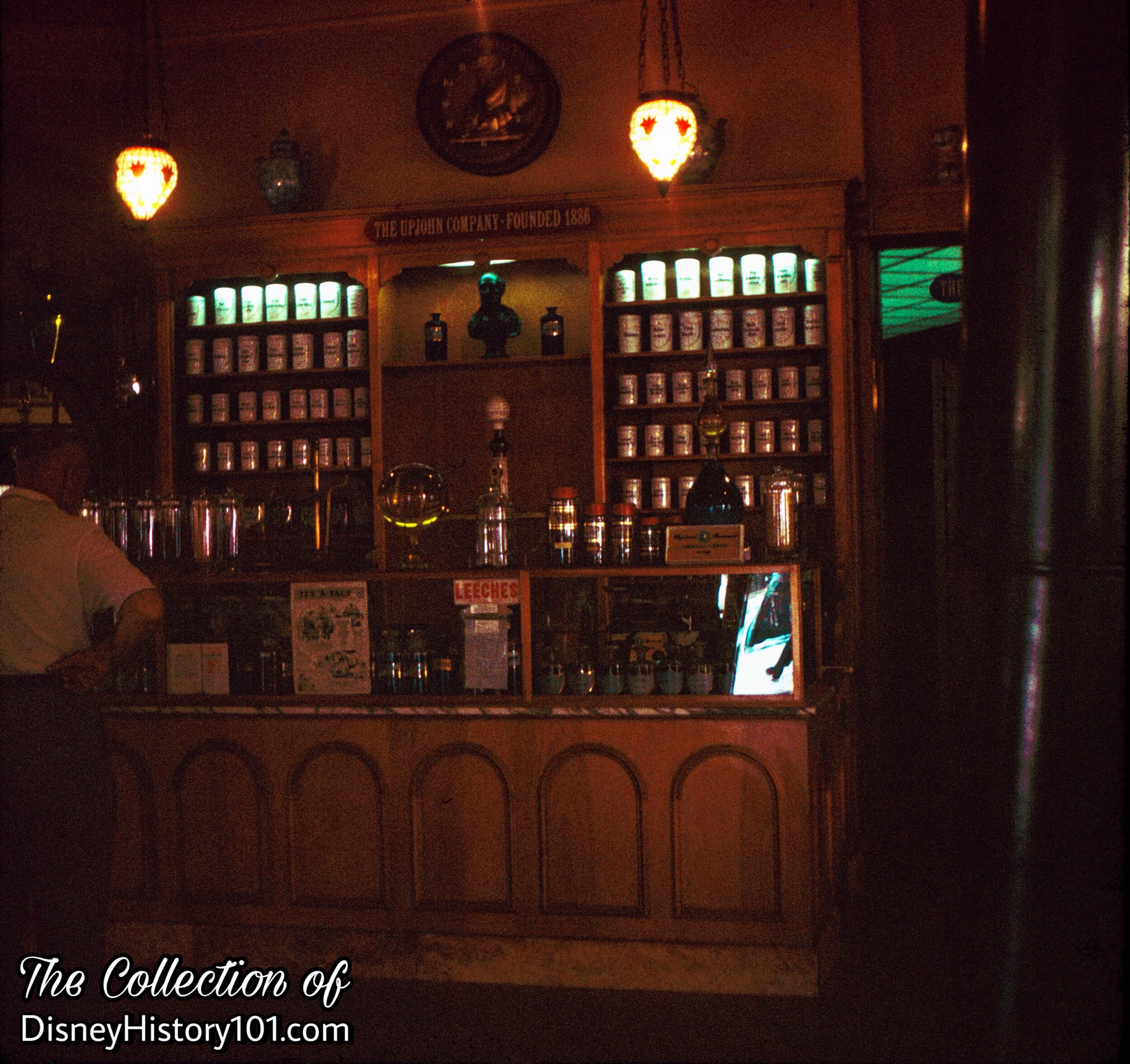
In the center of the counter, you can see the jar holding genuine leeches on display such as were used in medical practice before modern-times.
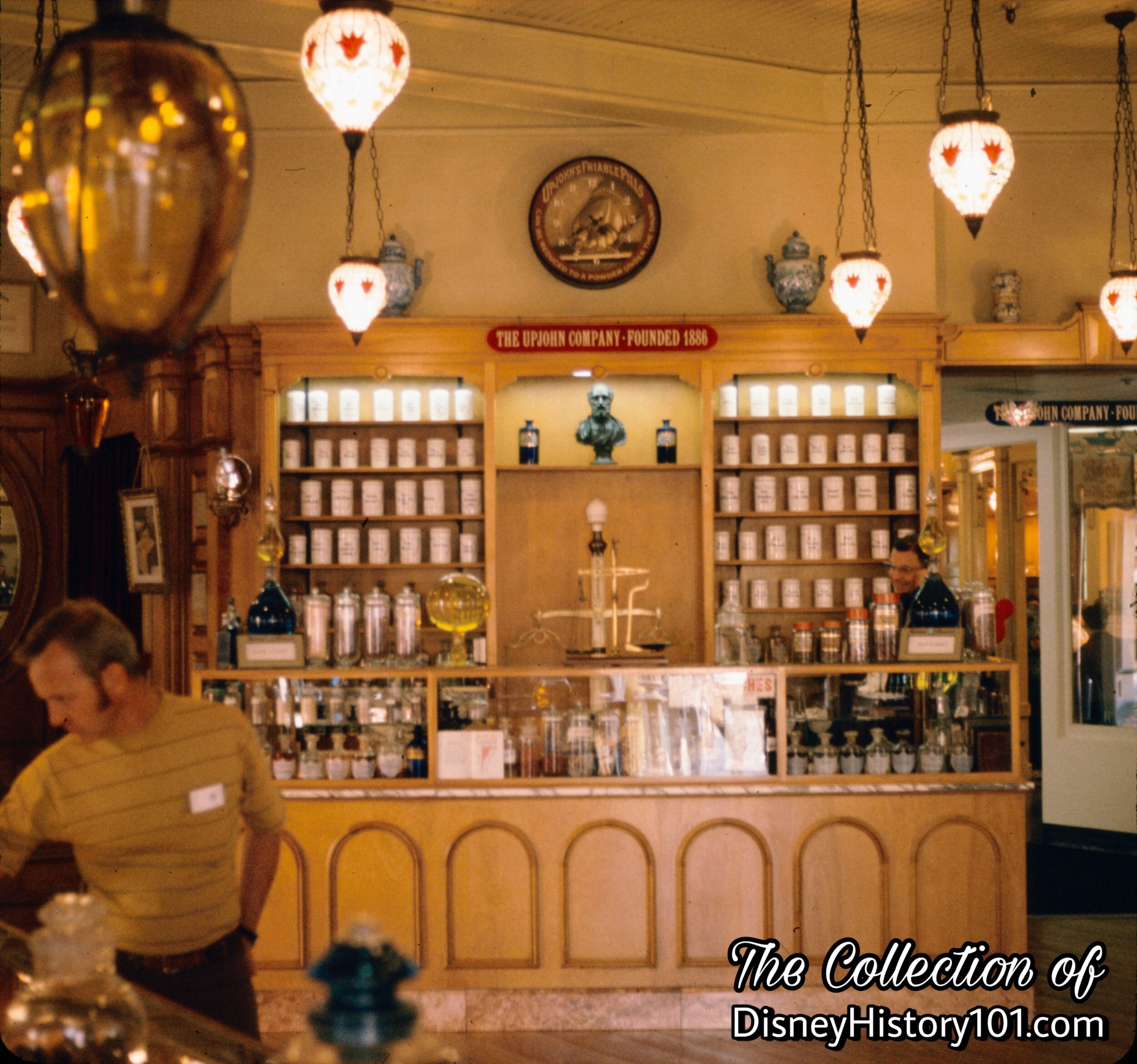
Guests like Disneylander Ron Dominguez (who thought about leaving after his first summer in 1955 and originally wanted to be a pharmacist) may have been inspired by the exhibit.
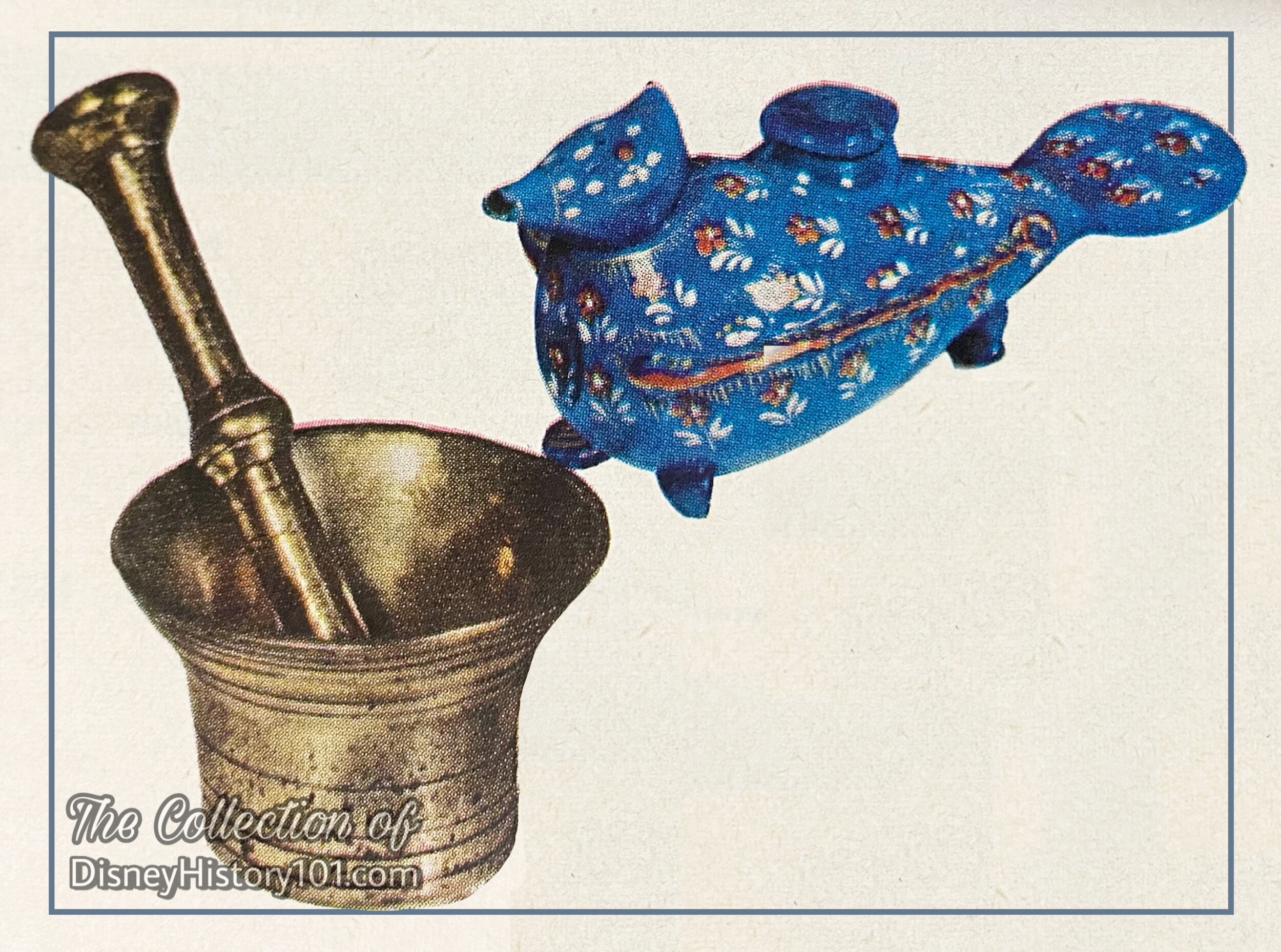
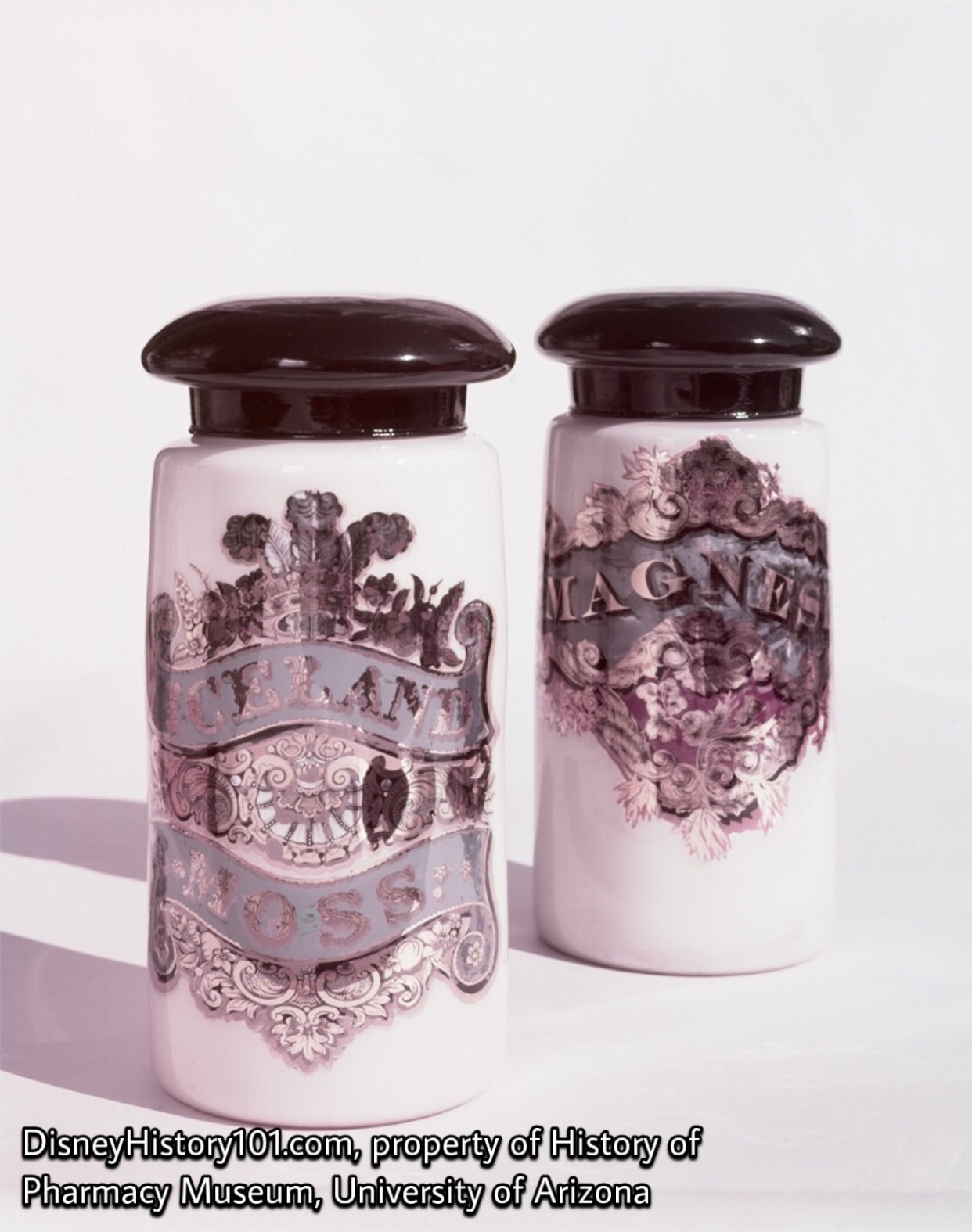
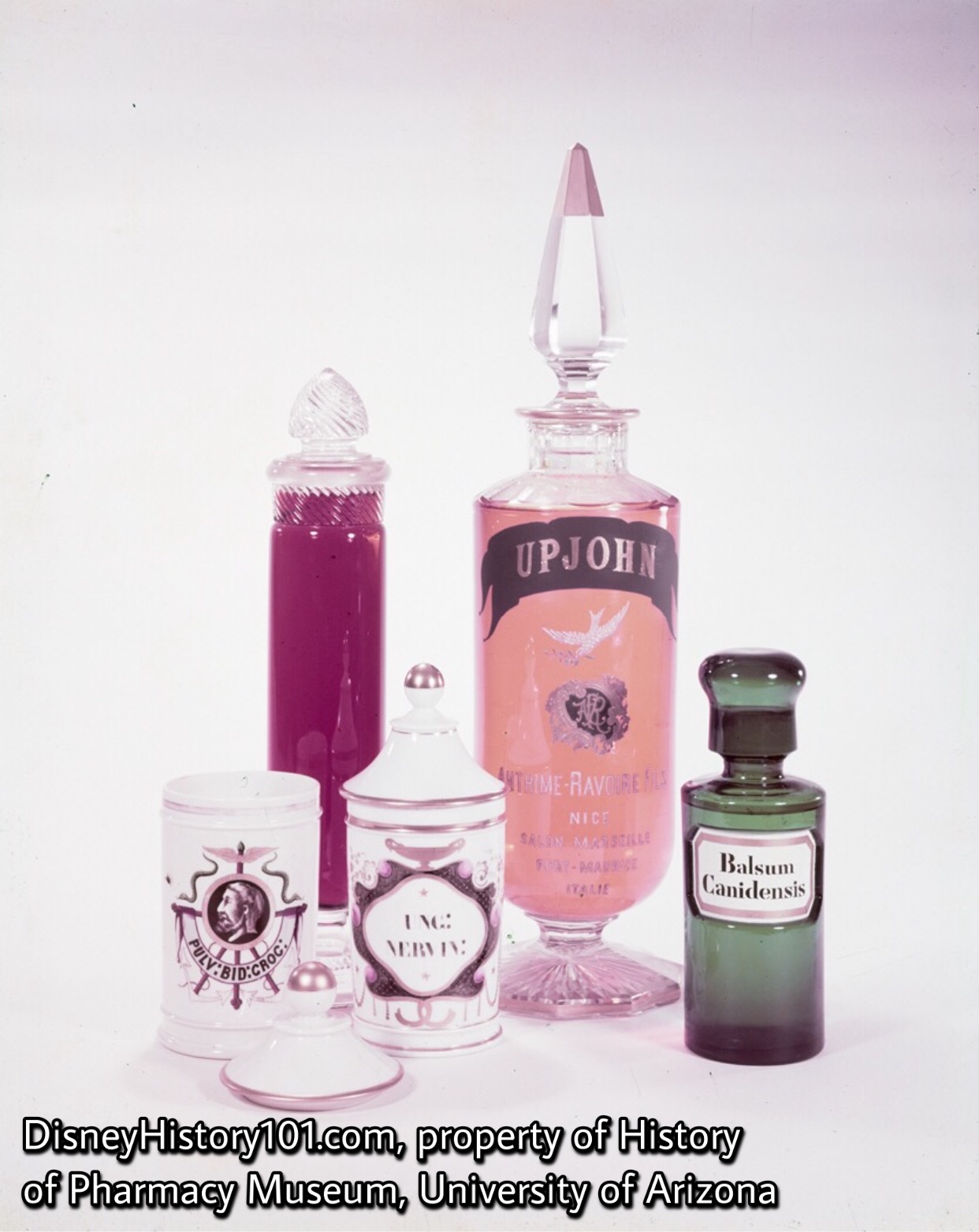
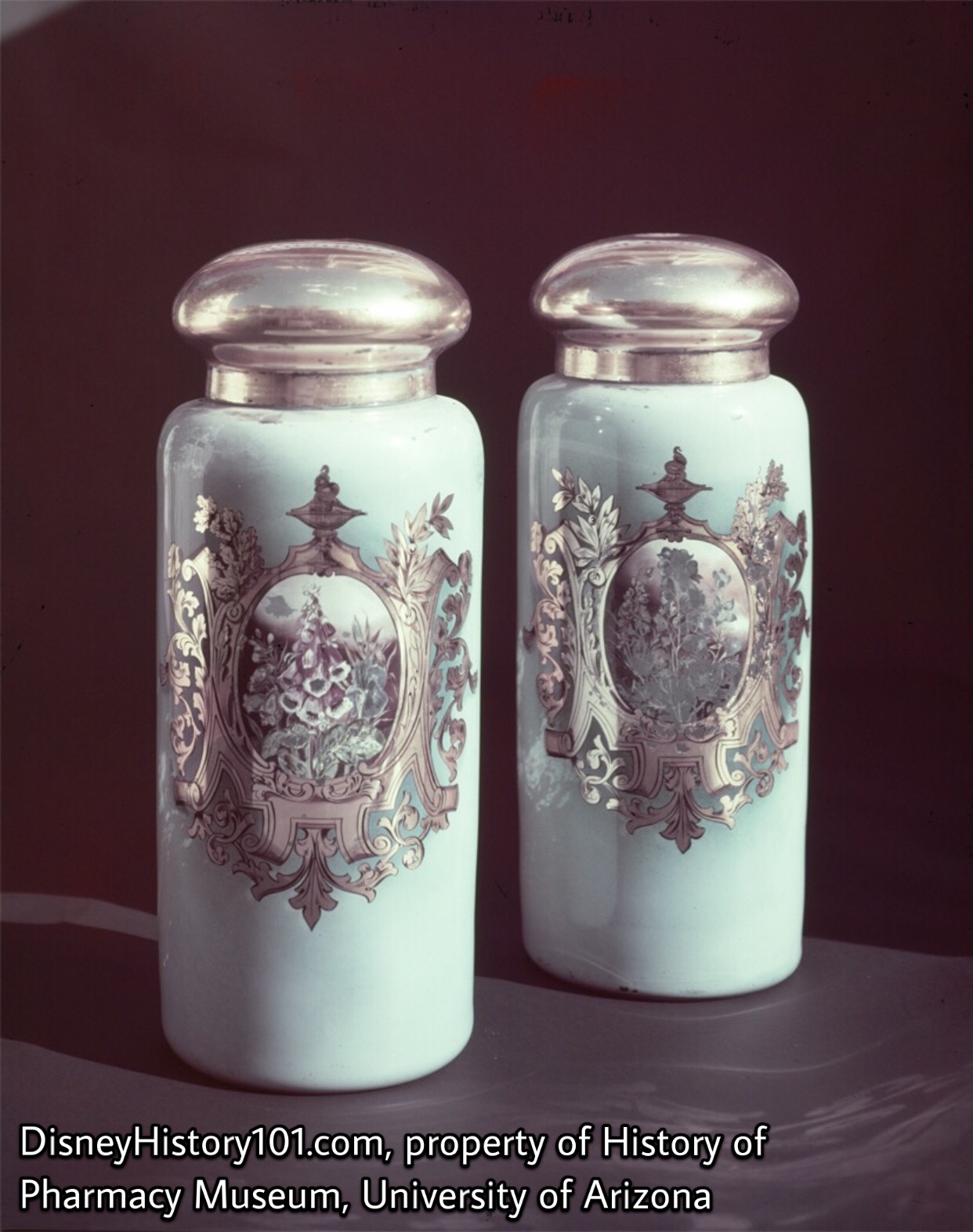
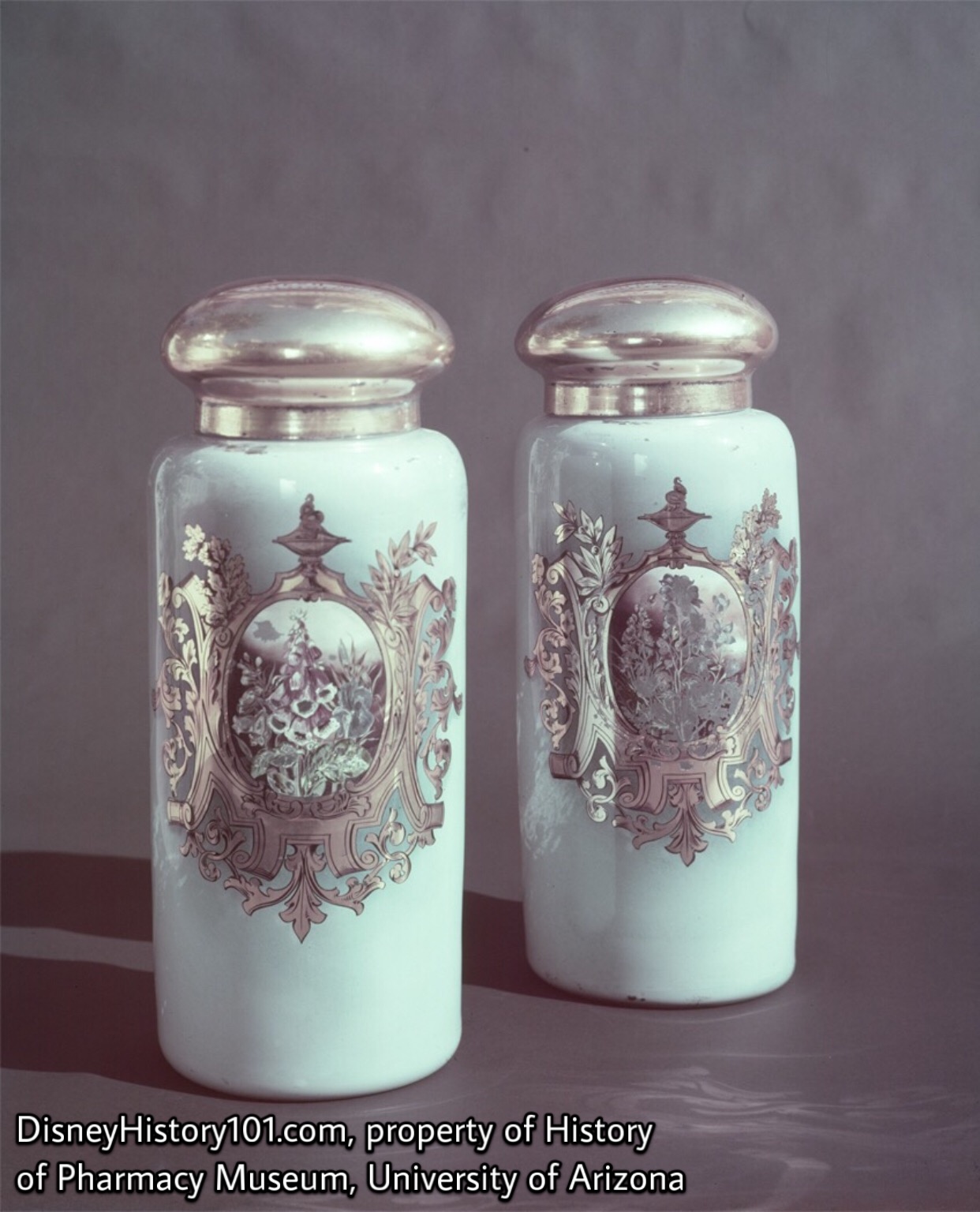
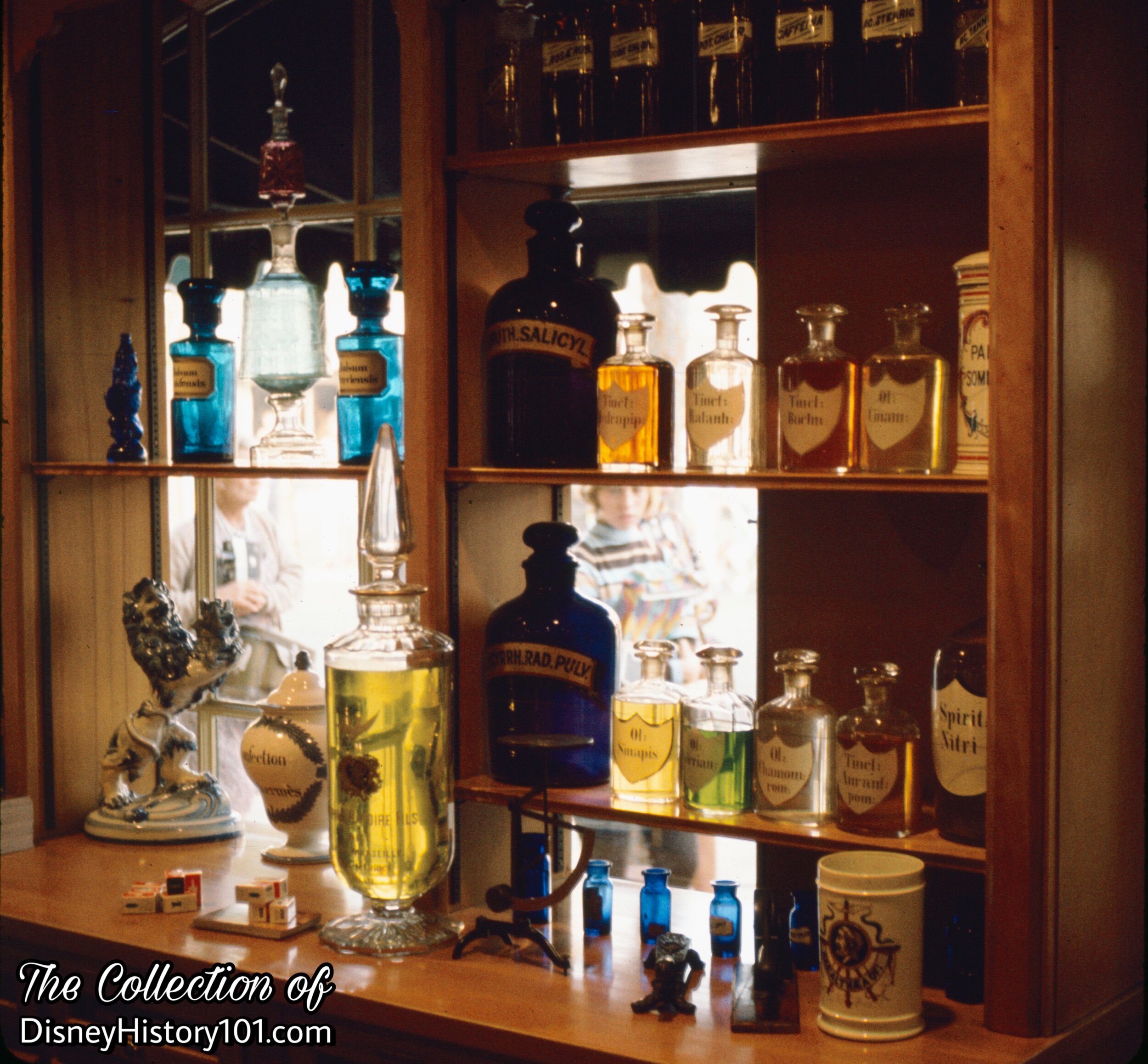
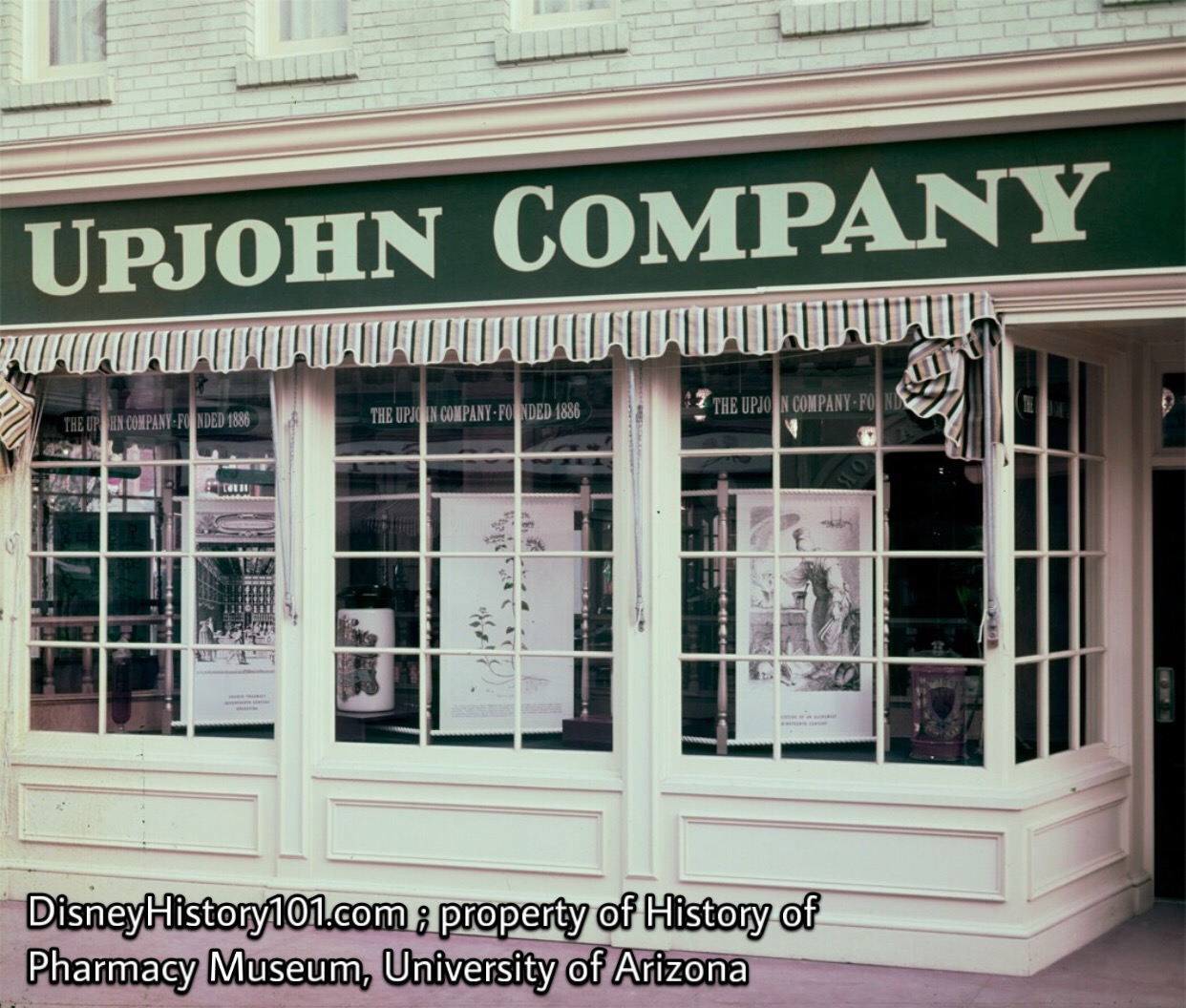

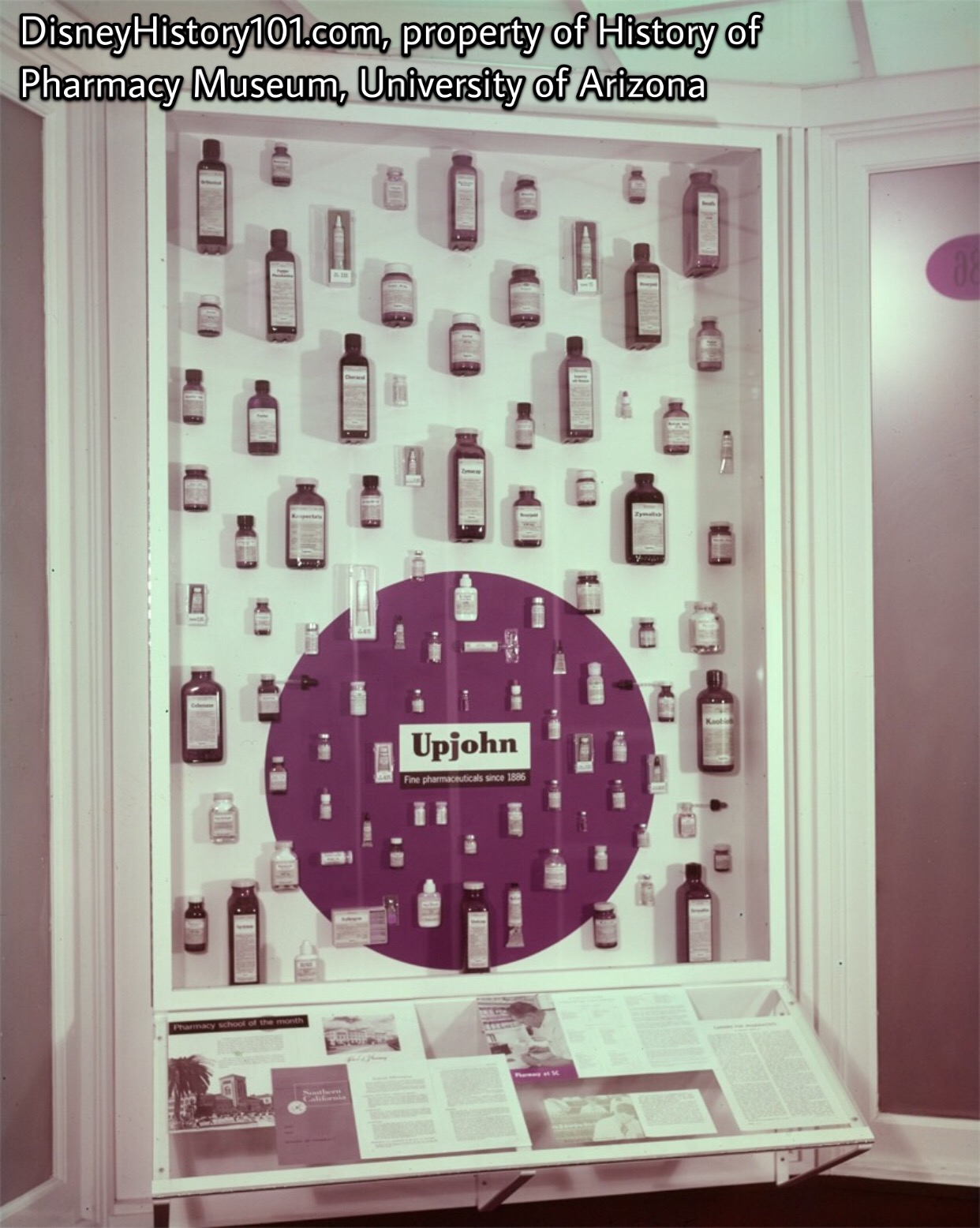
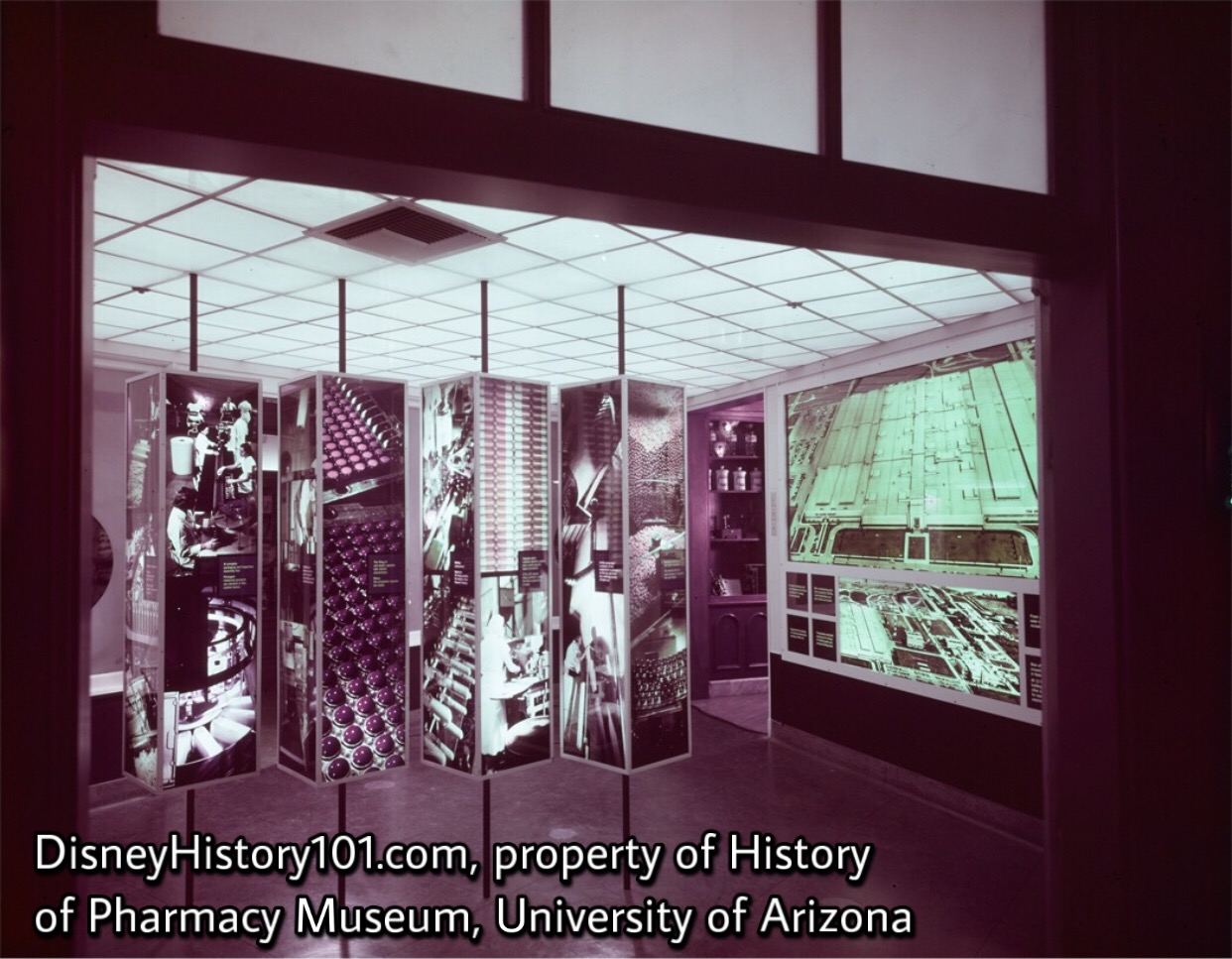
The $15,000 addition of the Modern Room was added in 1958.
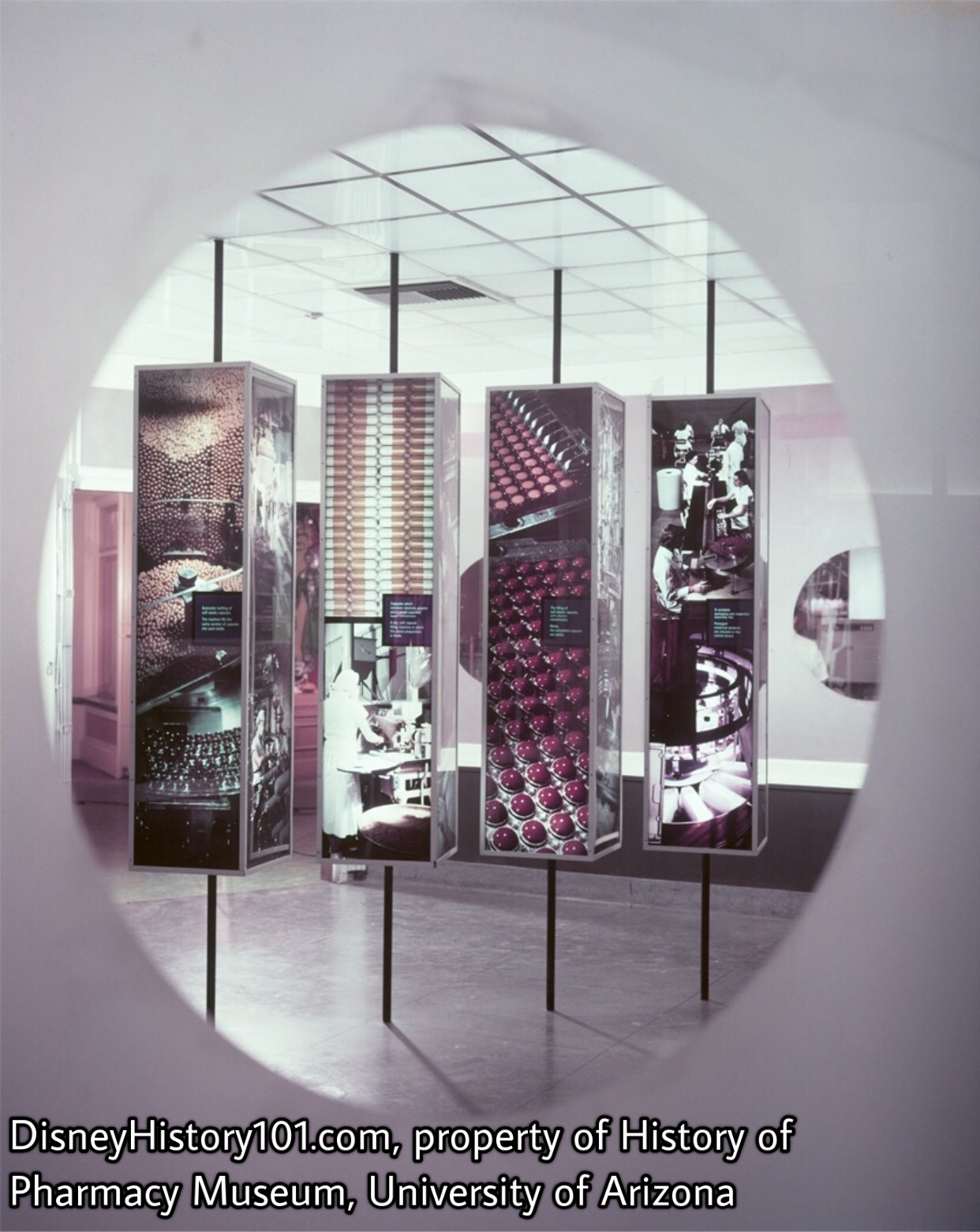
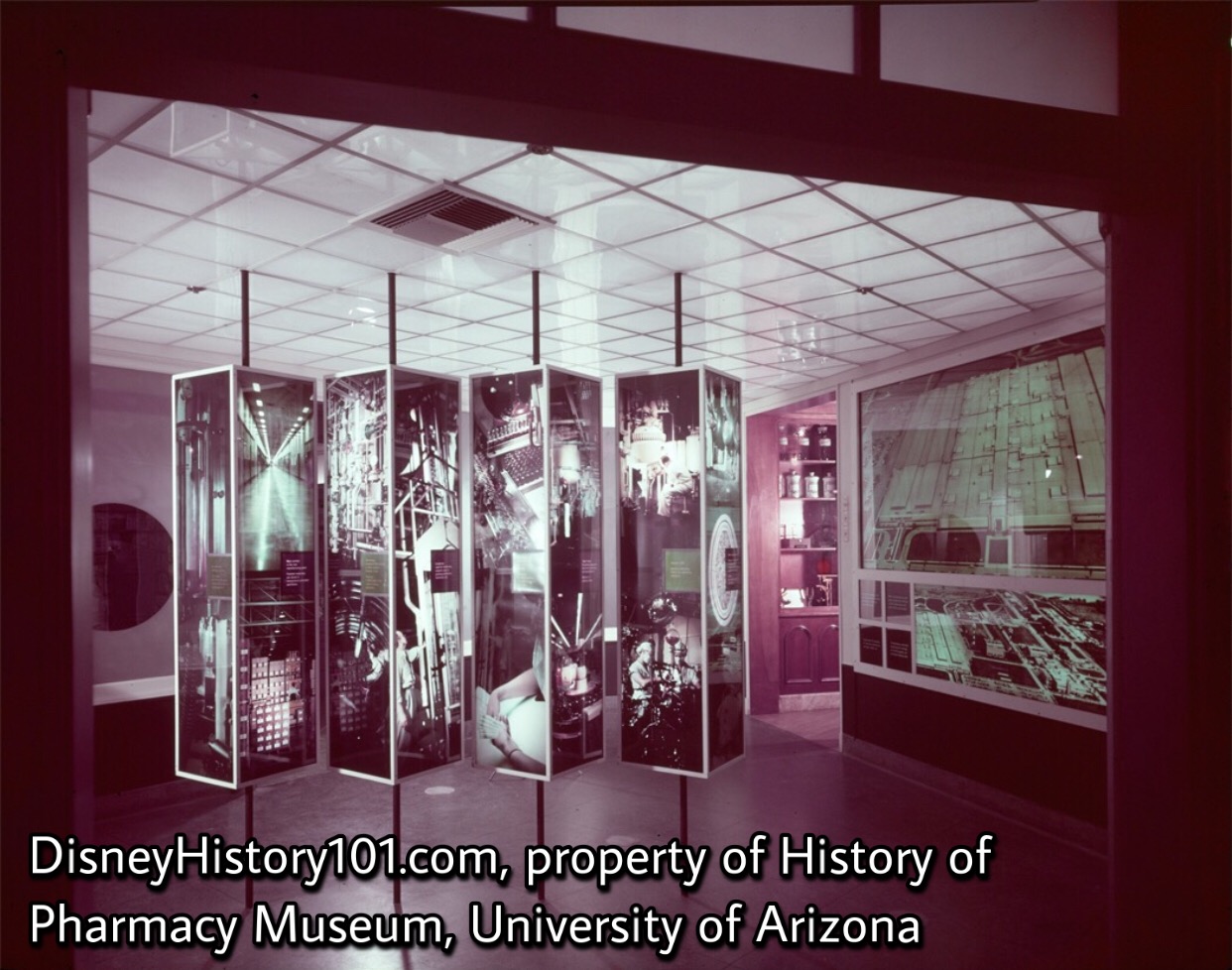
"As you have seen, the fixtures and equipment in the typical drugstore of the late 1800's bear little resemblance to the ultra-modern pharmacy that serves your community today. The basic philosophy of the pharmaceutical profession has, however, remained constant : integrity of service '; quality and purity of product.”
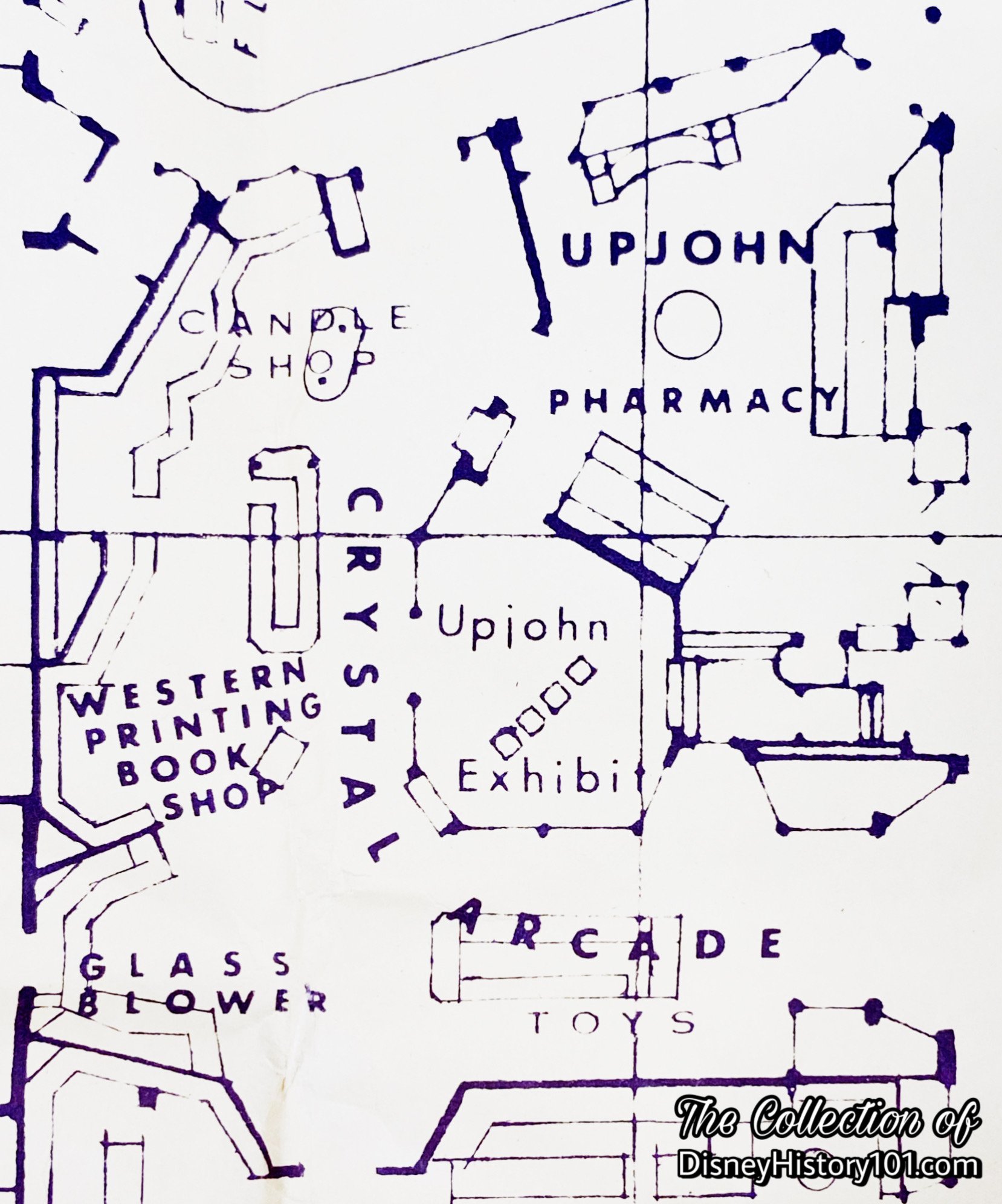
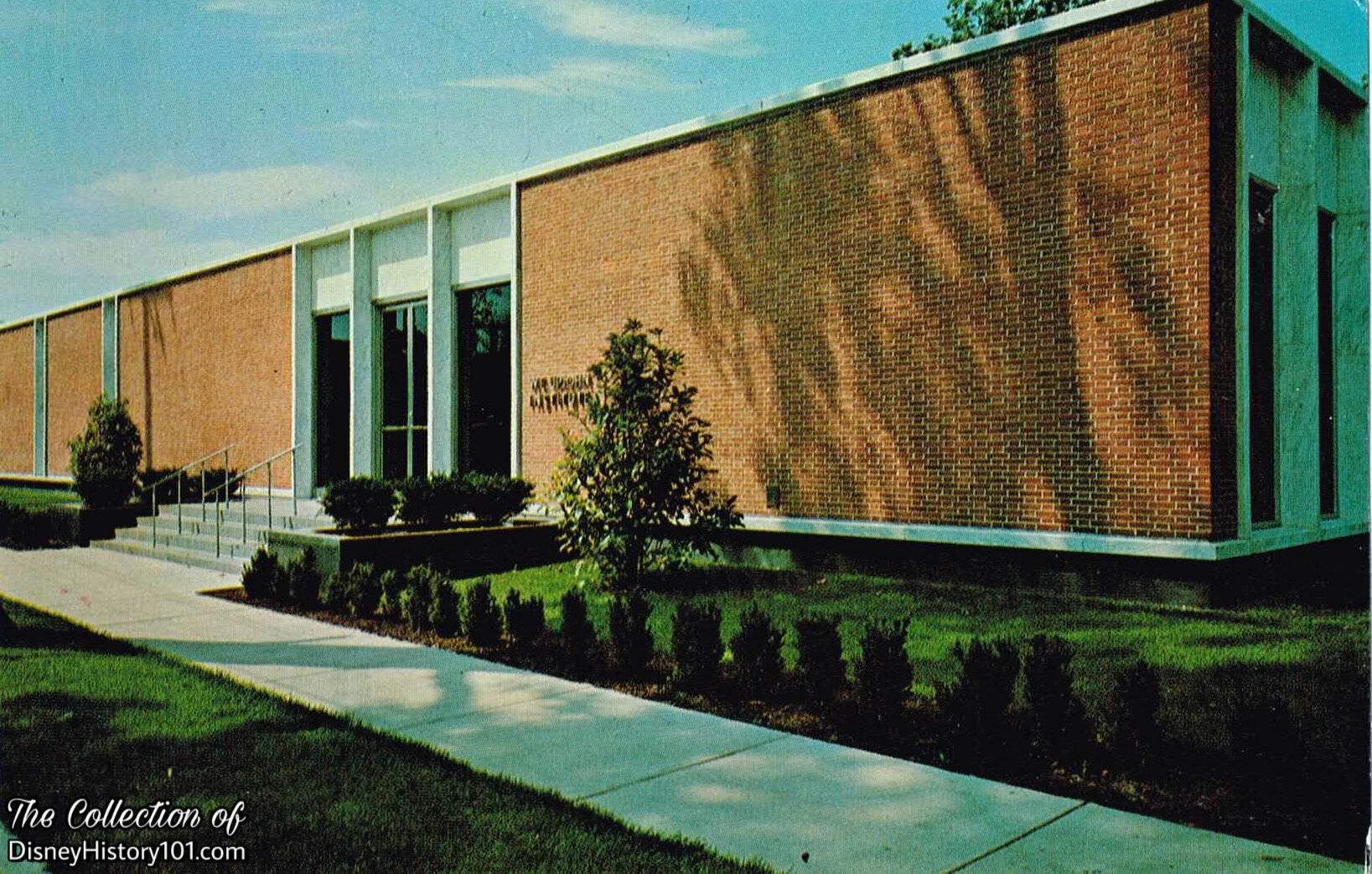
The new Upjohn facility in Kalamazoo, Michigan was a “23-acre facility under one roof”.
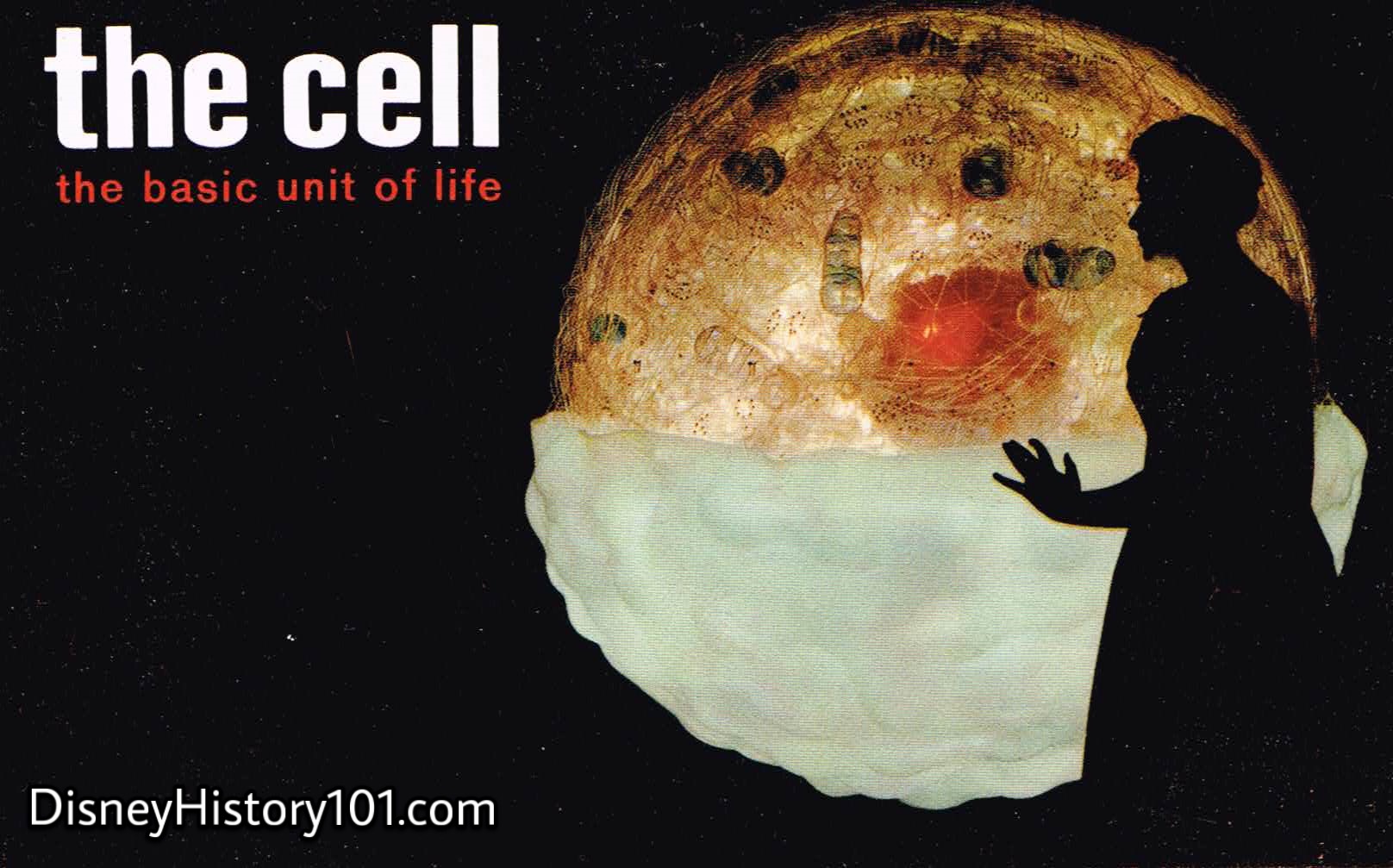
The Modern Room also featured additional displays over the years, like a display illustrating 20,000 years of medicine history added July of 1966. Another memorable display was this dynamic model of a human cell designed (by Upjohn Company resident graphic designer, and “Scope” Magazine Art Director - Will Burton) as an educational tool for physicians, cytologists, and students. Will had previously manufactured many displays and exhibits for Upjohn - models of proteins, models of vitamin pills, X-ray refraction patterns - usually on exhibition at the Kalamazoo Art Center. Now, Upjohn commissioned a total of three models of the human cell. By September 28, 1958, Disneyland Inc. job number 4012-515 for the Upjohn Company “Micro-world exhibit” was in progress at a cost of $13,056.
The original (and much larger) Upjohn-sponsored model (which was a precursor to the one appearing at Disneyland), first required a year for “its research, its collation of fact and surmise, and for its construction. Representative of no particular part of the human body, it is an abstraction of the cell - but a controlled abstraction, as technically accurate as the knowledge and conjecture…could make it.
Magnified more than 1,000,000 times the size of a human red blood cell, the model is [more than 20] feet in diameter and 11 1/2 feet high [though Disneyland’s was much smaller in dimension]. It sits on a metal mirror, so that as a viewer walks through and around, he has an impression of being inside the organism, at the center of it. The model is constructed of acrylic plastic tubing for the cytoplasm, or the outer material. There are some 2200 pieces in the cytoplasmic structure, measuring 3700 linear feet, their 7500 joints connected by hand. This…structure is built on a five-piece irregular module regularly repeated with the pieces…[fitted] together at an angle of 78 degrees. Along the…’wall’ are displayed scale models of all the elements of the cell. Because nothing of its kind has ever been attempted before, new problems of conception required novel solutions in construction, for example the chromosomes {the long curly forms in the nucleus} are made of vacuum cleaner [hoses]”, according to Industrial Design magazine (published August, 1958).
Still, the smaller version that exhibited at Disneyland, featured many of the same parts of the “organic whole” display - from the transparent and rigid mitochondria (where food is transformed into energy), to the flat sack-like endoplasmic reticula (believed to once be responsible for the formation of the cel’s proteins)! This display was so popular that it was moved around and displayed in several places (after its Disneyland exhibition), and it was even featured on a Disneyland postcard during 1960!
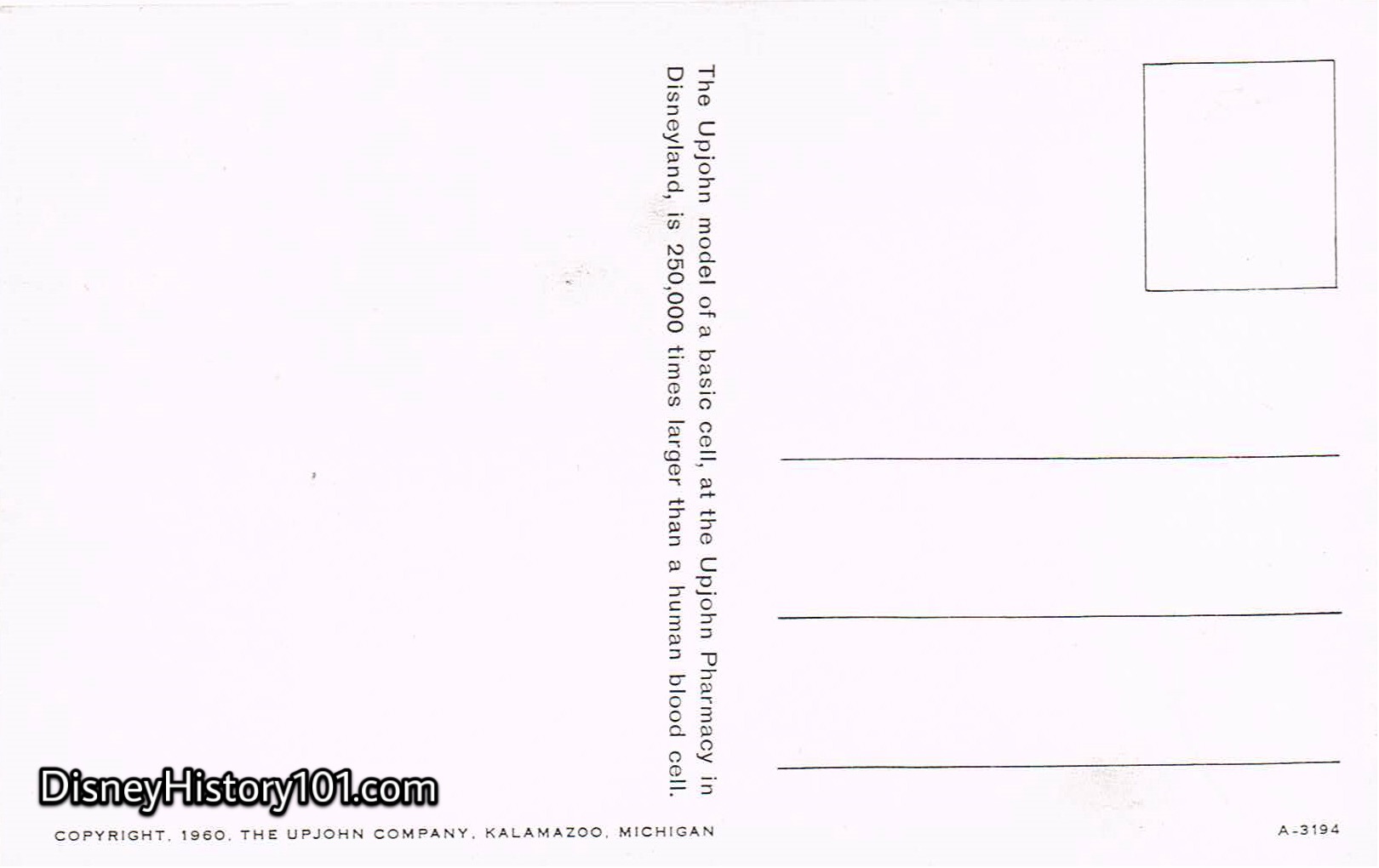
The back of the Upjohn Postcard featuring the human cell carries an interesting fact about the size of the model. The model is a staggering 250,000 times larger than the average human blood cell!
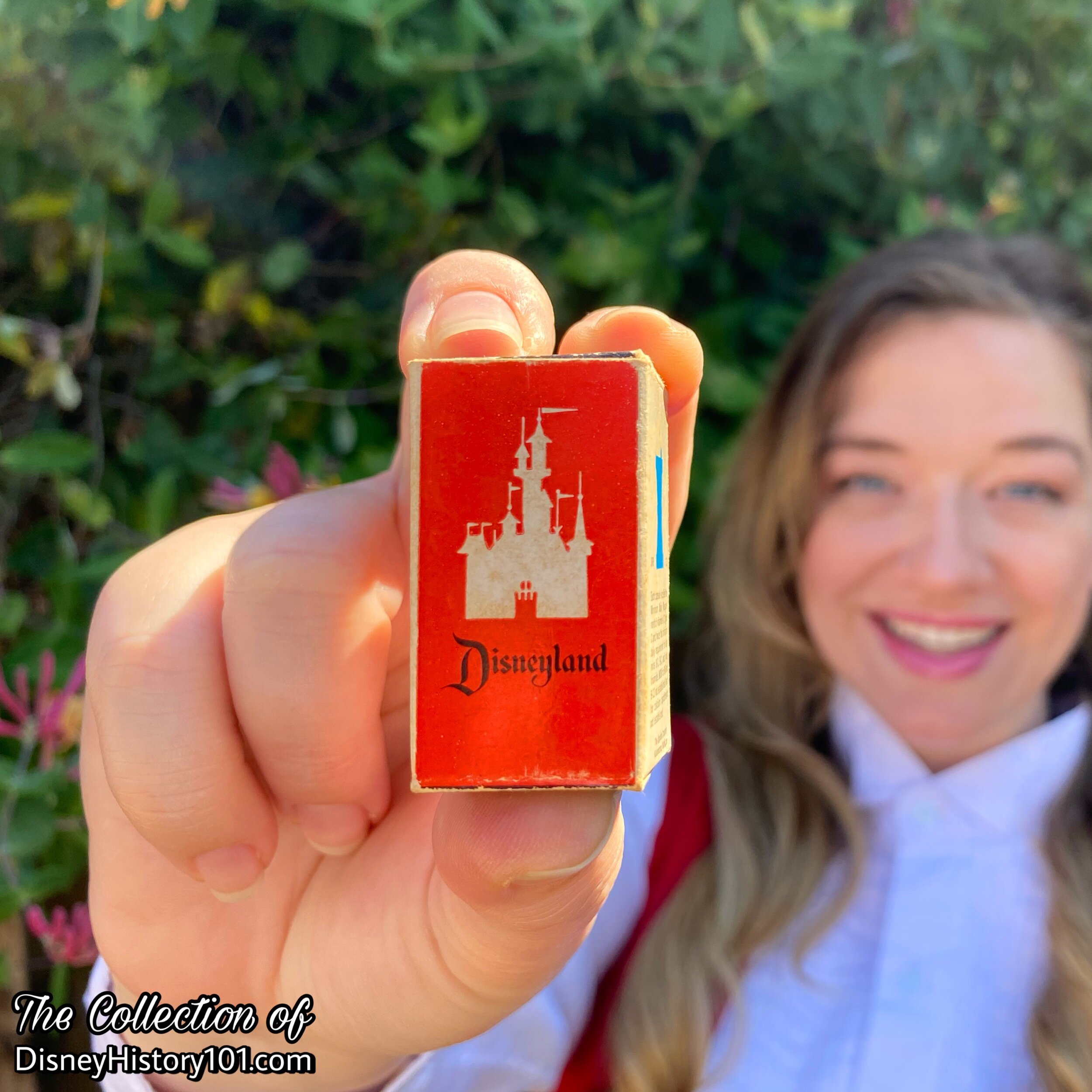
You may recollect receiving this “souvenir of Disneyland”, that was a complimentary item given to guests of Main Street U.S.A.’s little corner drug store.
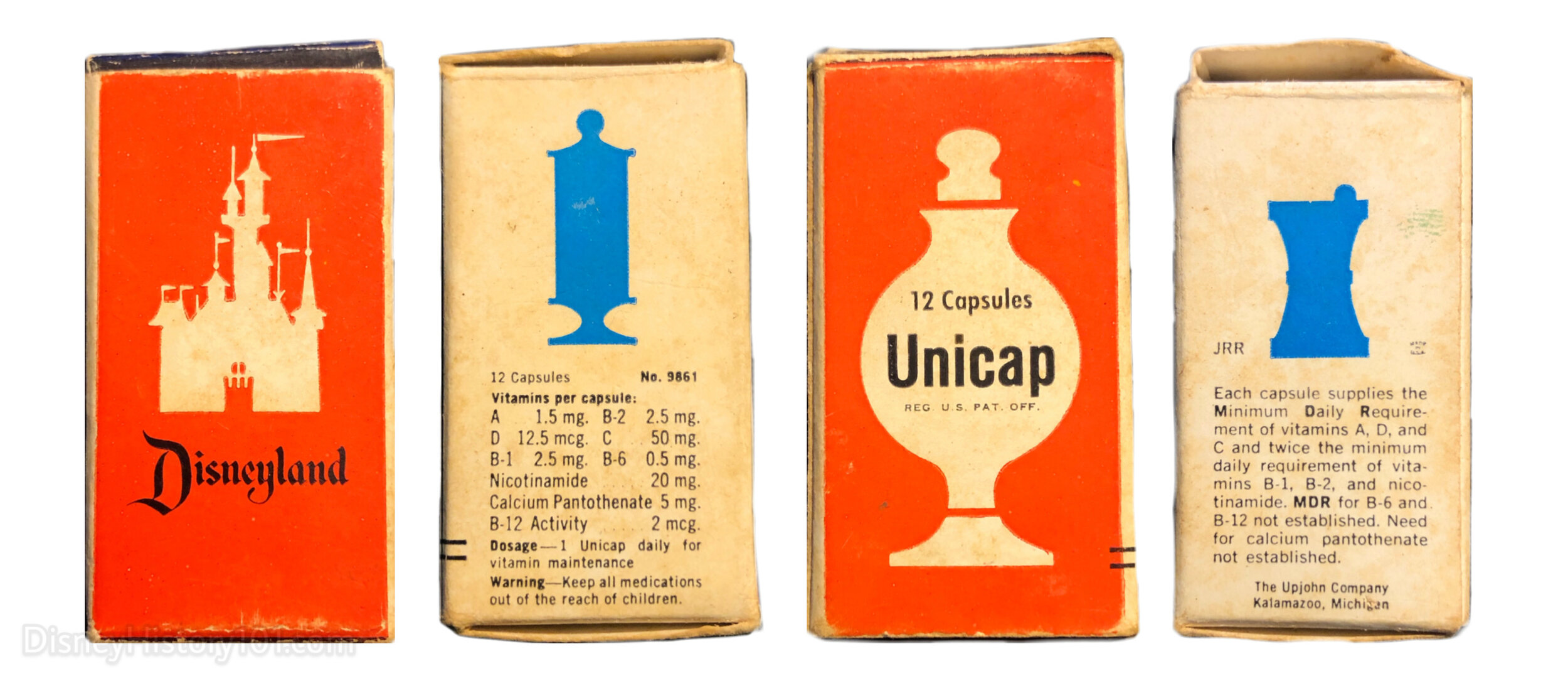
Through the years, the boxes (which contained the sample bottle of 9 to 12 “Unicap” capsule pills) generally had an expiration date stamped on them. These were sample portions of actual medicine pills (minimum daily requirements of A, D, and C, Nicotinamide, twice the daily requirement of B-1, B-2, and possibly the daily minimum requirement of B-6, B-12, and Calcium Pantothenate). “Unicap… [was] just one of the hundreds of fine pharmaceutical products produced by the Upjohn Company” and was once available at your local pharmacy. These samples were not to be confused with the bottles of “Pixie Dust” from Doctor Tinker Bell, recommended in doses measuring “a pinch”, to “relieve the blues, blahs, and frowns of an occasionally bad day.”
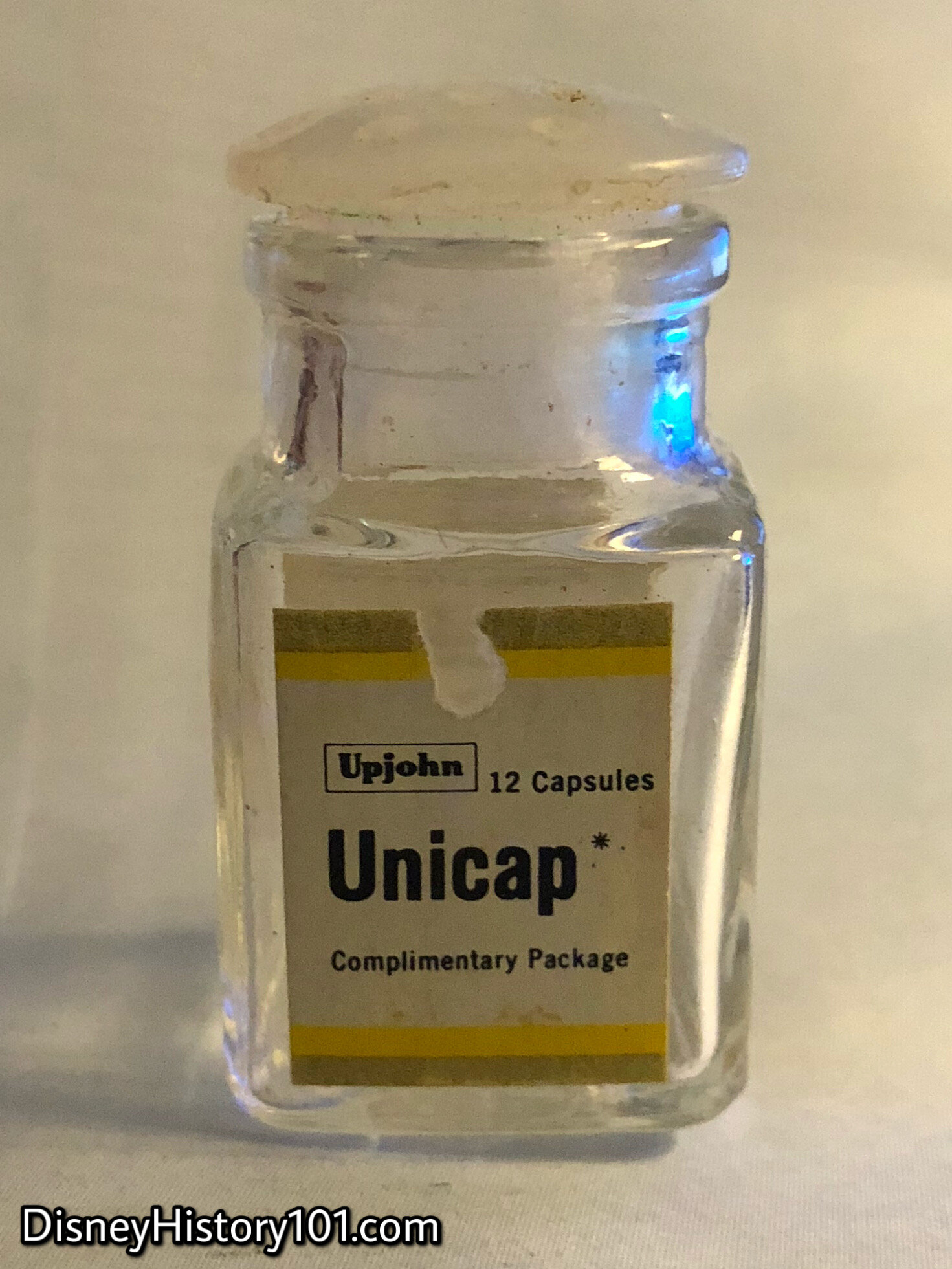
During 1962, Disneyland Guides reminded guests, “If you are just a bit worn out at the end of the tour, remember to stop by the Upjohn Pharmacy for your free vitamin pills.” Perhaps you still have your souvenir bottle somewhere?
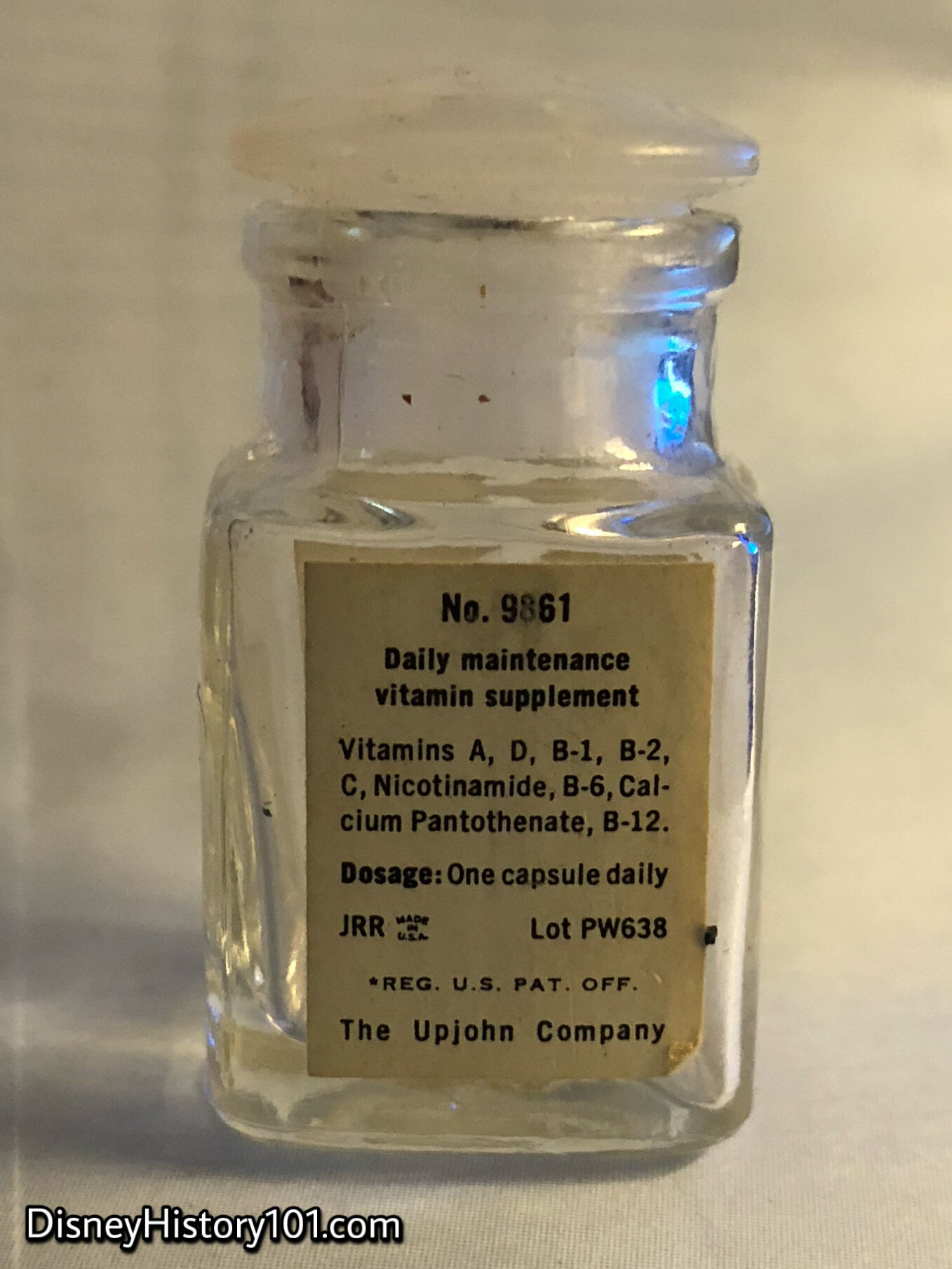
According to an accompanying label :
“Each UNICAP multivitamin capsule contains ten essential vitamins and provides these vitamins in greater amounts than the minimum daily requirement (where established) to insure adequate vitamin intake. UNICAP multivitamins are just one of the many contributions of the Upjohn Company since 1886.” These samples (according to literature contained inside the box) were proof that “the basic philosophy of the pharmaceutical profession has, however, remained constant : integrity of service, quality and purity of product.”
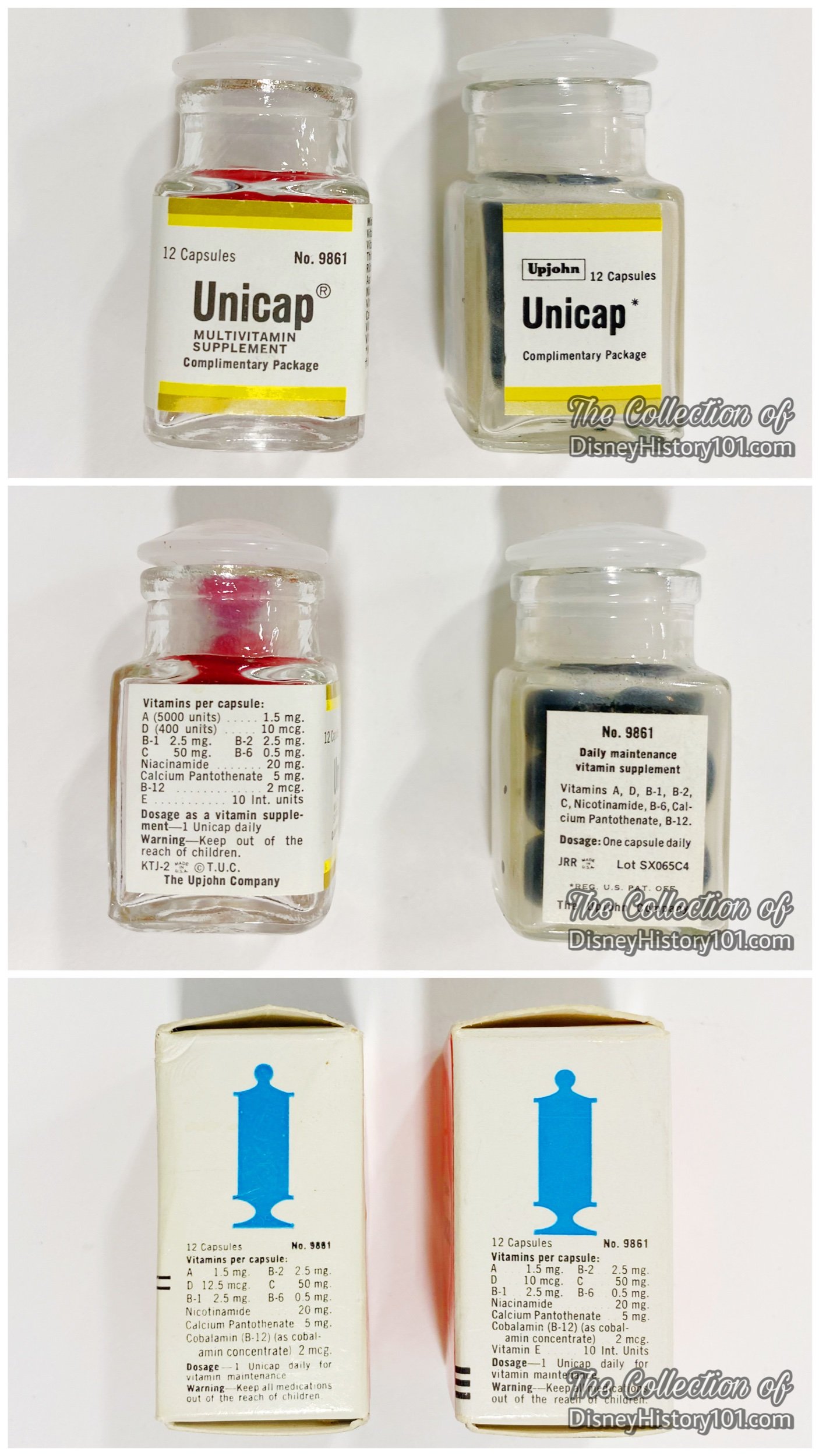

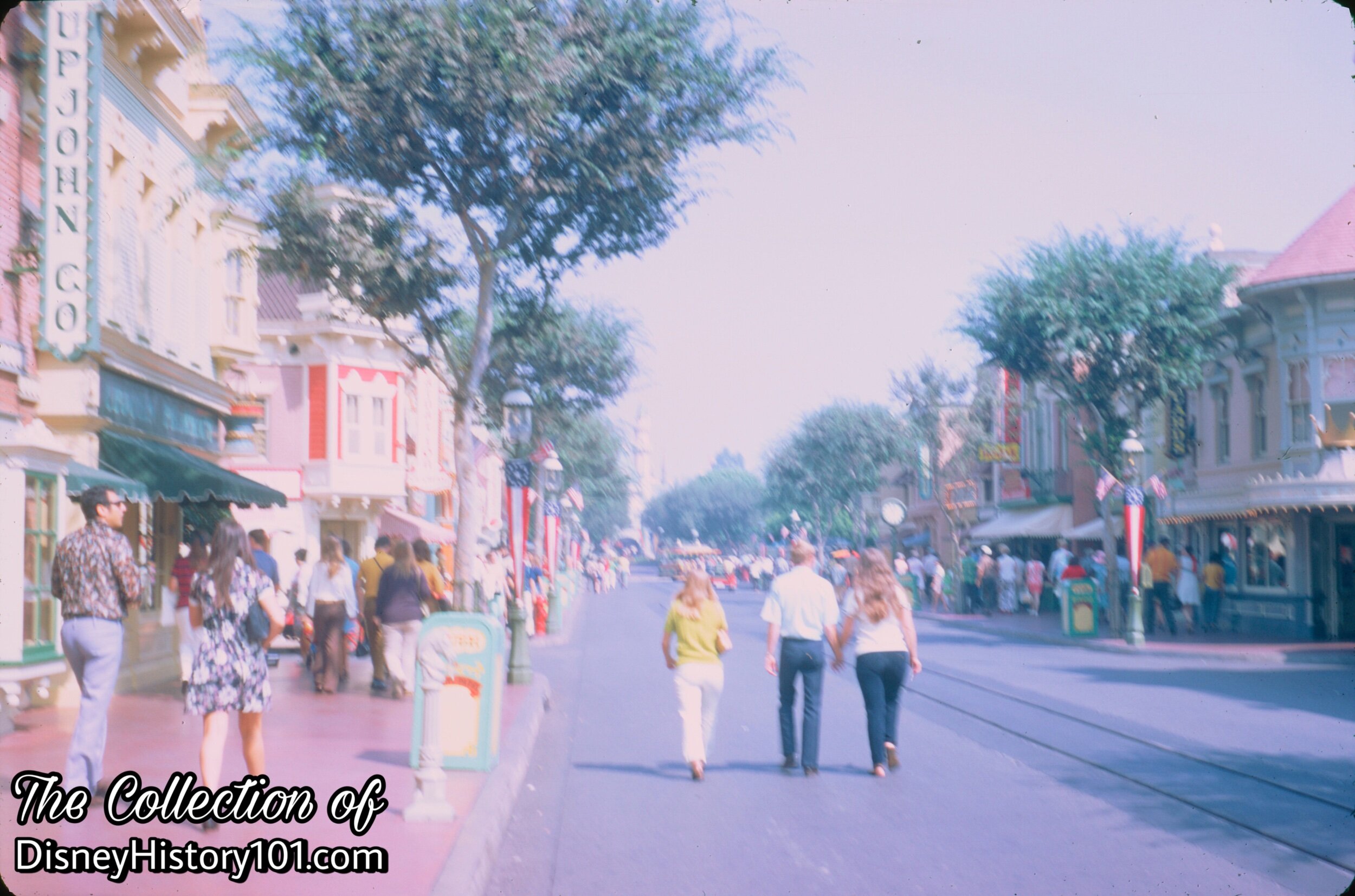
Ultimately, Disneyland Participant Affairs and Disneyland Participant Upjohn Co. could not negotiate a new cooperative agreement to maintain their ongoing relationship, so the two “reliable old firms parted ways.” Here we are in the month of August (pictured above), and the end of an era for the Disneyland of Walt’s era. The folks who took this photo may not have known that this was one of the last times the Upjohn name (one of the original sponsors) would be seen on Disneyland’s Main Street U.S.A.!
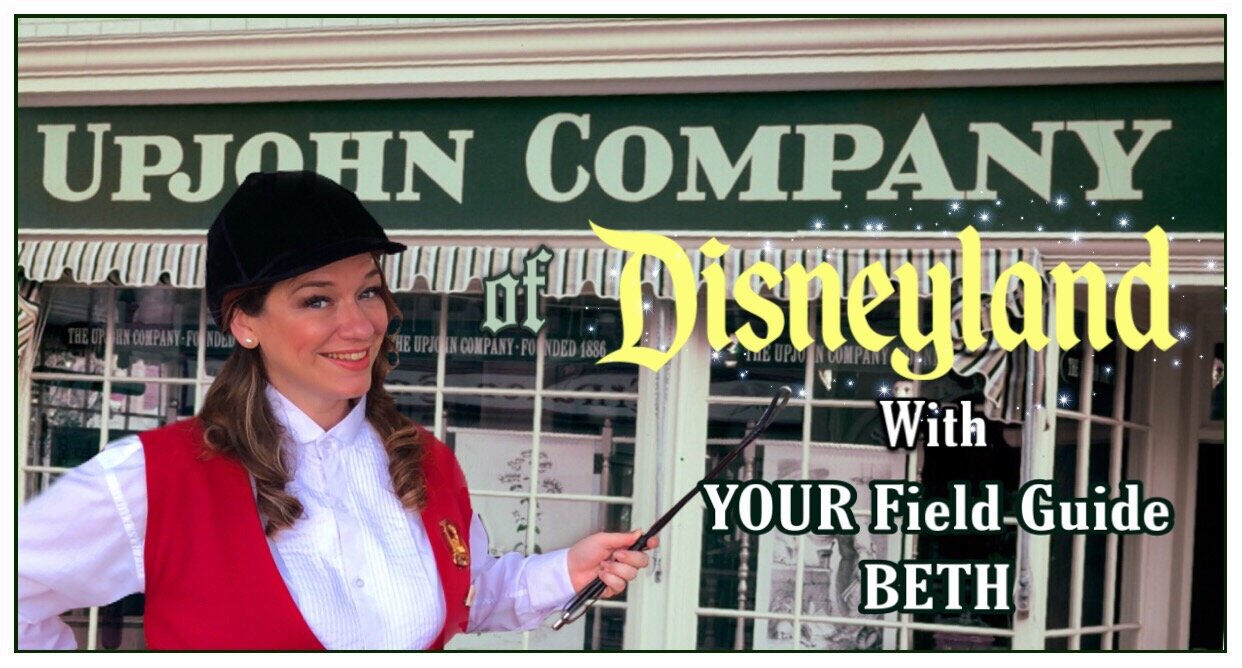
Considering all of these displays, it is easy to see why by the year 1958, the Upjohn Pharmacy was considered one of 15 free educational shows and exhibits at Disneyland. Ultimately Upjohn corporate sponsorship ended, and the Upjohn Pharmacy closed. However, much of Upjohn’s collection of antiques is currently being preserved at the University of Arizona.
PLEASE, STEP THIS WAY, as Disney History 101 prescribes the following tour of Upjohn Pharmacy with your Filed Guide Beth! Along our tour today, we will explore how residents of Walt’s favorite vacation destination (Smoke Tree Ranch) played a crucial part in this opening day attraction. We will also visit Disneyland’s “working” pharmacy through a rarely-seen, collection of preserved Upjohn artifacts at Arizona State University!
Please step this way, as YOUR Disney History 101 - Upjohn Pharmacy Tour departs HERE!
Under the current agreement, four eleven-minute films will be produced within a period of two and a half years, their cost to be underwritten by the Upjohn Company, one of the world's best-known pharmaceutical manufacturers. Distribution will be made by our company through its 16mm Division.
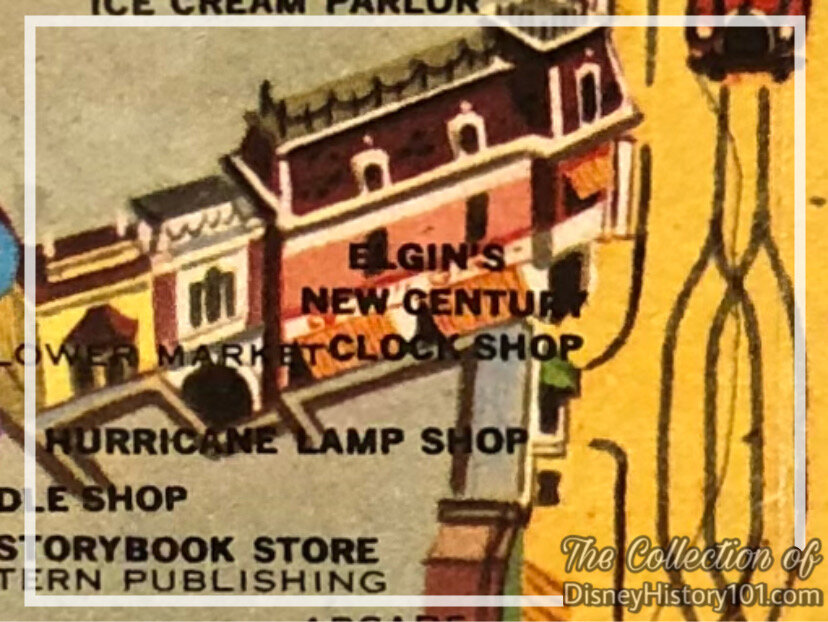
Soon, the Elgin Company (a then, reliable 100-year-old firm and a Disneyland Participant since 1971) moved (from the other side of Main Street) next door to Carnation.
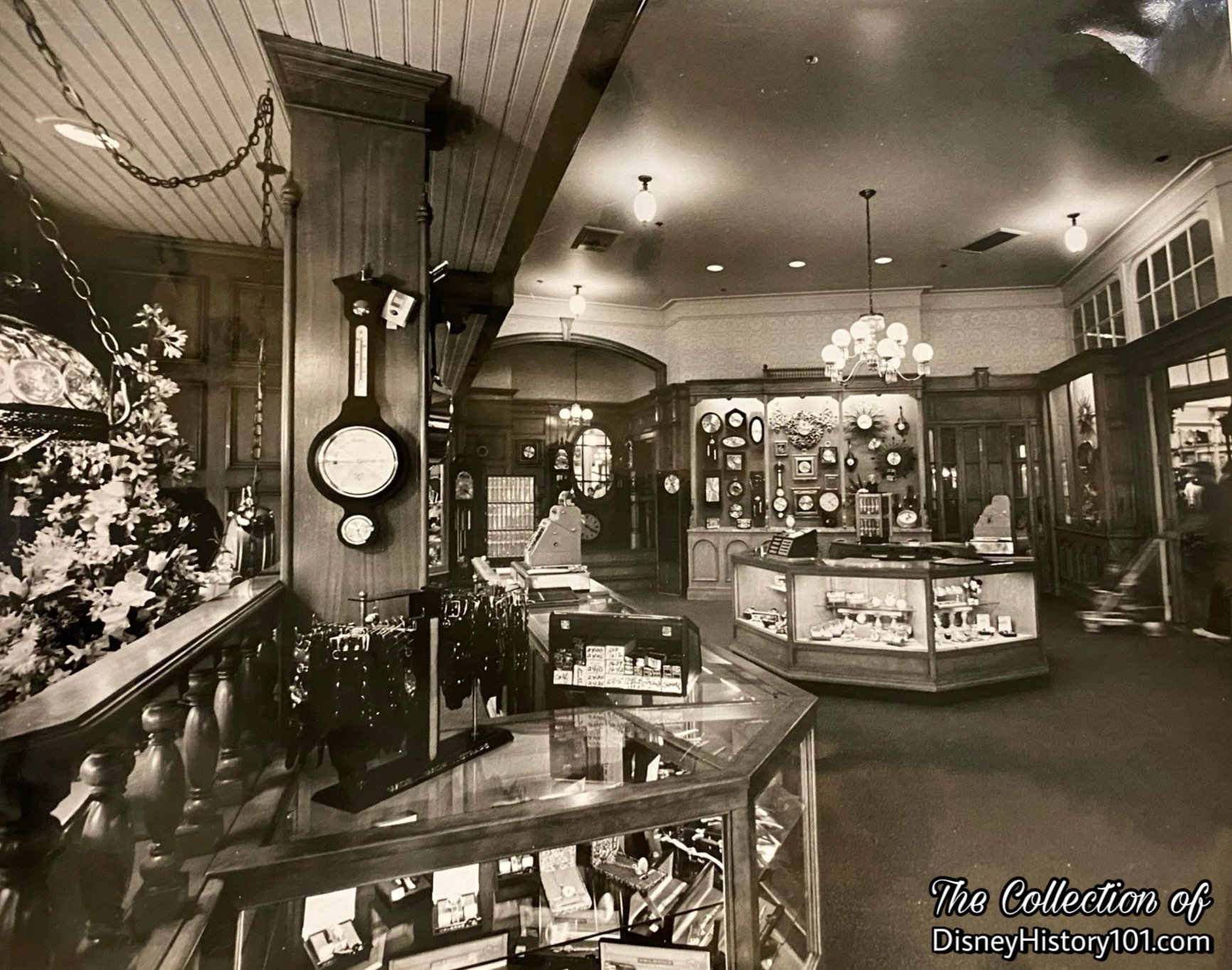
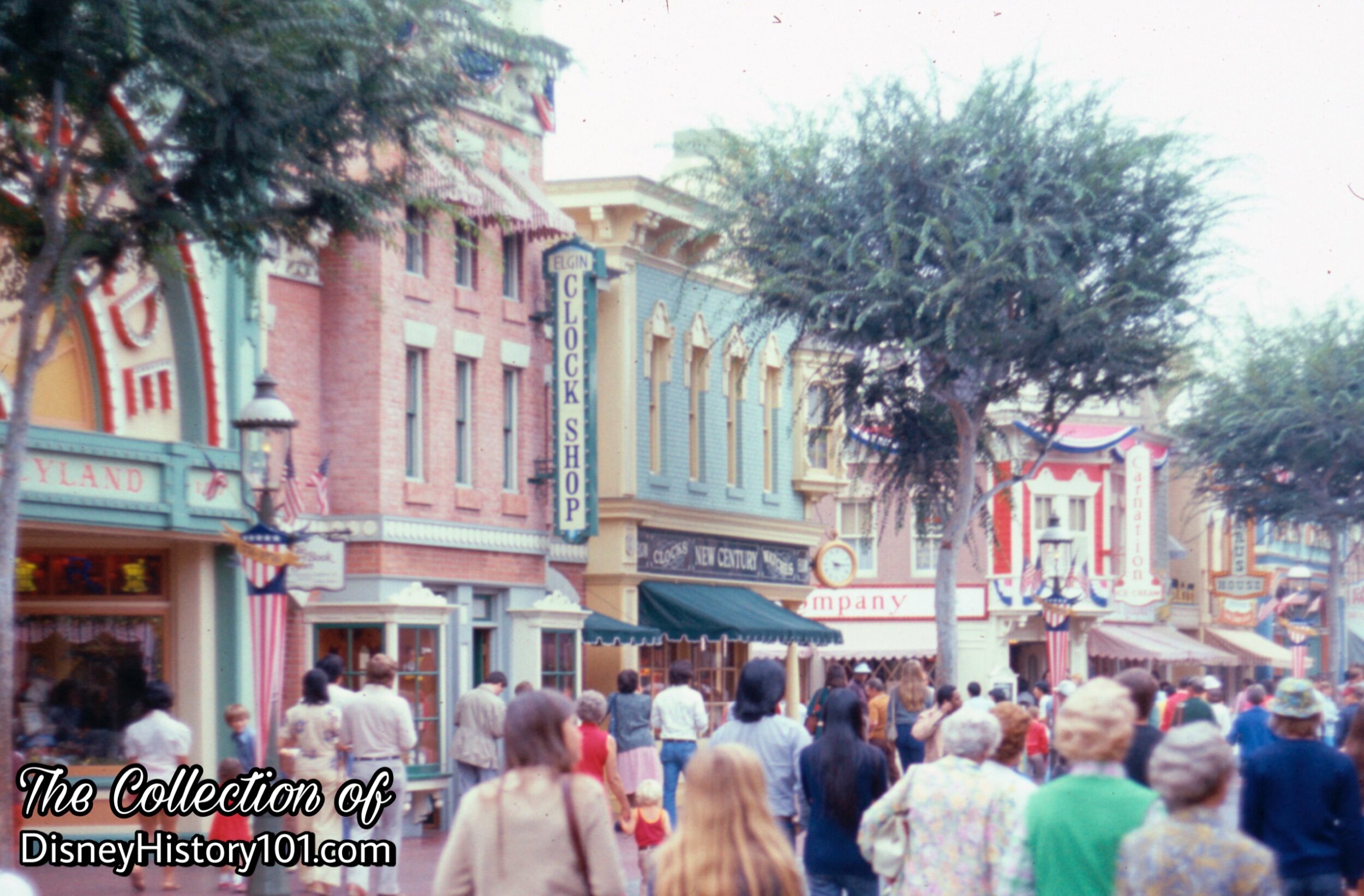
“Here, guests will find (or can order) calendar watches, automatic watches, chronographs, electric watches, electronic watches, casual and dress watches, pocket and pendant watches, and special watches such as Walt Disney character watches, divers’ watches, engineers’ watches, nurses’ watches, and sportsmen’s timers.
In the clock line, the shops features hand-wound, battery-powered, and electric clocks, wall clocks, kitchen clocks, alarm clocks, digital clocks, clock-radios, table clocks, and Elgin’s decorator clocks, including “Traditional Heirloom Strike and Chime Timepieces,” “Handcrafted Hall Clocks,” “Baroque Decorator Timepieces,” “Mediterranean and Early American Classics,” and “Galaxy” and “Contemporary” timepieces.”
The New Century Clock Shop would feature an exhibition of early antique Elgin timepieces, as well as 50 styles of Mickey Mouse watches including limited editions (just in time for Mickey’s 50th Birthday in 1978)! The shop was very popular and the shop’s team of employees were successful. High sales records were achieved during the following two years - on August 7, 1979 ($10,662), and on August 15, 1980 ($12,062).
New Century Clock and Watch Shop hosted by Elgin-Timepieces by Elgin, featured a complete selection of Mickey Mouse and Disney Character watches and clocks. Unique themed watches (like the Swiss-made “The Black Hole” Wrist Watch by Bradley, released 1980) were made available at Disneyland and fine stores everywhere. An unnumbered limited edition Haunted Mansion exclusive watch featuring the Bride was released on the 26th and 27th of an unknown year.
Imagineer Eddie Soto’s proposed “watch program” ran from 1994-2013, and when it ended, “a large batch of original artwork for the watches was… acquired by the Walt Disney Archives,” according to Dave Smith (Chief Archivist Emeritus of the Walt Disney Archives). [Disney Facts Revealed by Dave Smith, 2016] In 2008, WDI master plans entertained the concept of a merchandise update for the Clock Shop.
“Upstairs,” one second story window above the New Century Jewelry Shop features the name of “Dr. Benjamin Silverstein M.D. - General Practitioner - Have a Fever? Have the Flu? Come on in and we’ll cure you!” As “fortuosity” would have it, Dr. Benjamin Silverstein M.D. “inhabits” the address above the former site of the Upjohn Apothecary Shop. While Benjamin does not seem to be based on a true-life individual, it is one of the few locations at Disneyland where both a mezuzah (and, “shema” on the doorpost) as well as a menorah can be found on Main Street U.S.A. (the latter placed in the window during the winter season).

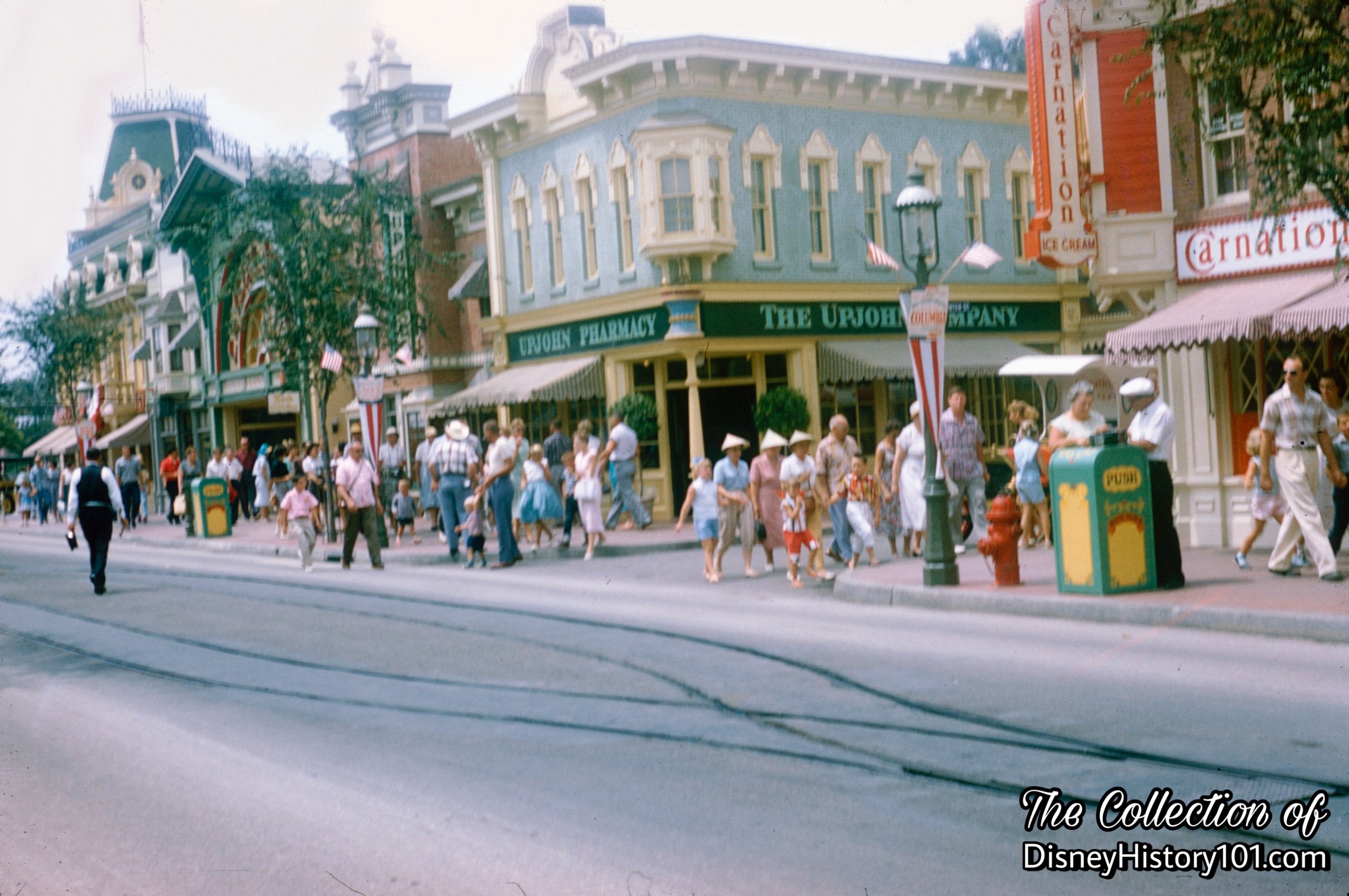
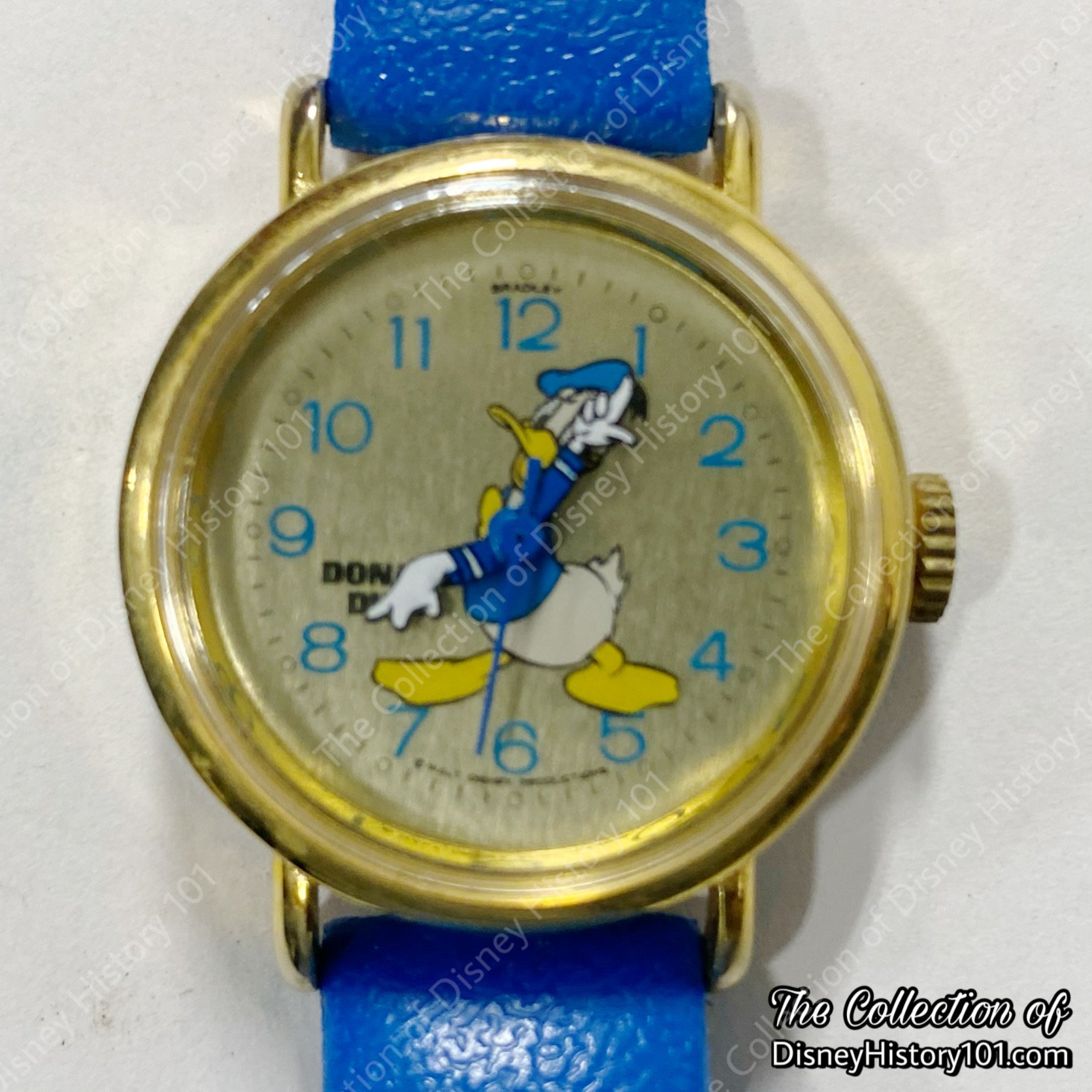
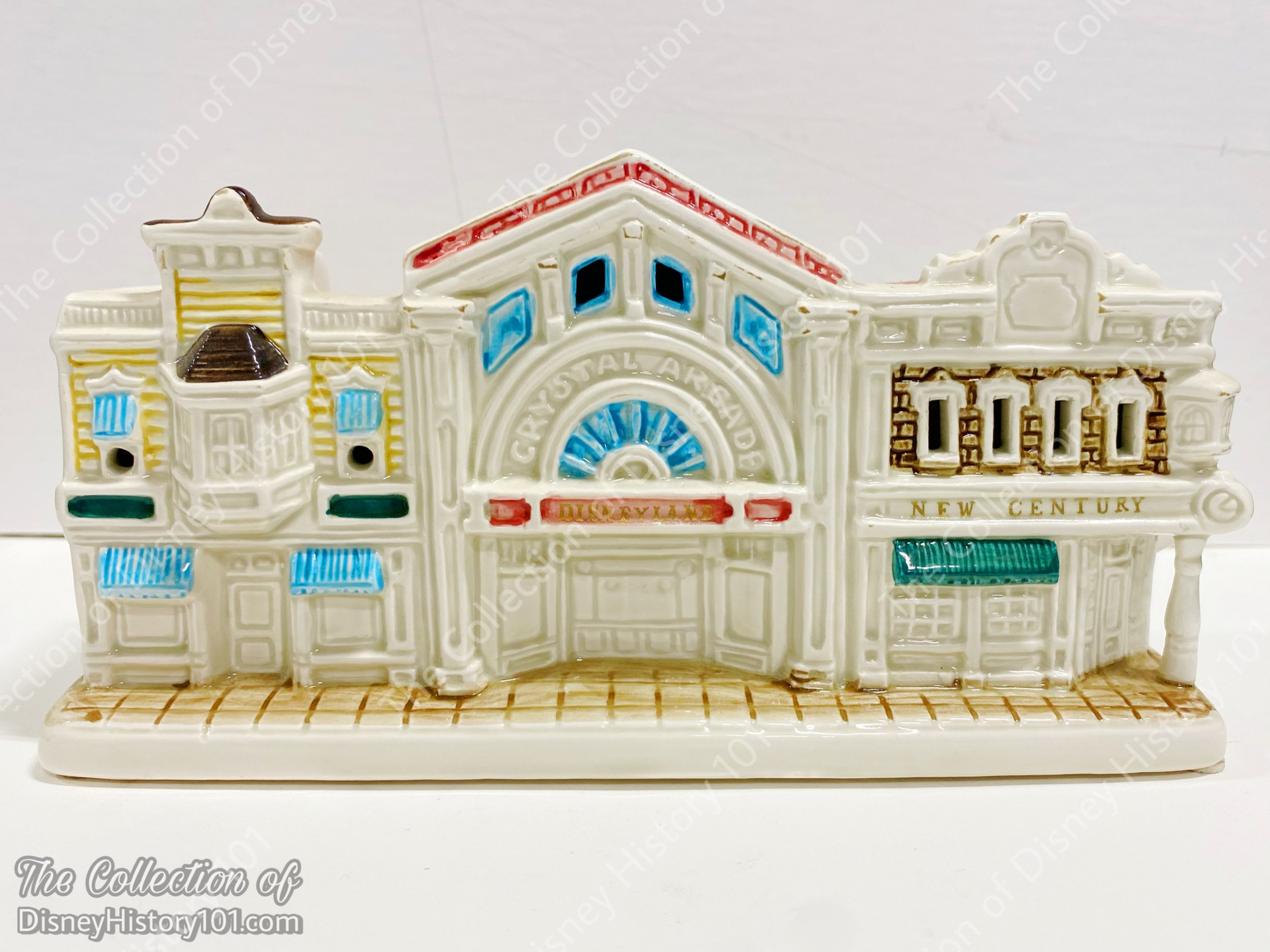
VIEWLINER TRAIN OF TOMORROW
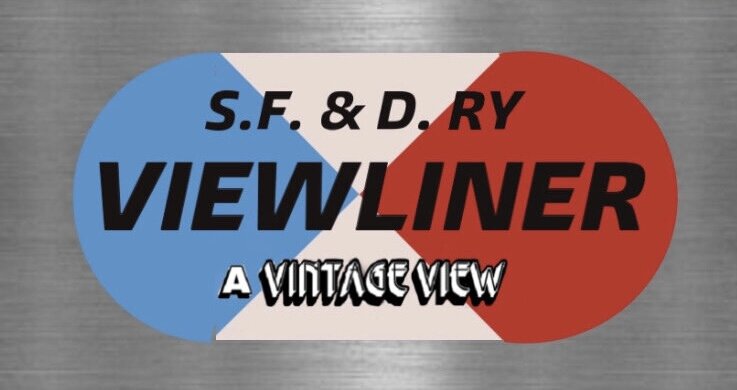
*Some sources cite a soft opening date of June 21st, 1957.
At Disneyland there is a "story behind the story" of every attraction, every attraction is a living experience for the guest. Disneyland ride-through attractions or adventures have officially been defined as an “individual show, ride, or exhibit designed to produce an entertaining Guest experience. Disney attractions stir the imagination, enliven the senses, and provide the participants with positive, innovative entertainment, which is the essence of the DISNEYLAND Show.” It is important to review the story of the attraction, tell the story, explain it, and create interest. This is the story of the Viewliner.
“Concept”
You may recall hearing how Walt Disney, on the eve of Disneyland’s first day of operation, promised that “Disneyland will never be completed. It will continue to grow, to add new things, as long as there is imagination left in the world.” One such “new thing” was the shortest-lived attraction - the Viewliner! The Viewliner “high speed train of the future” was designed and built by WED Enterprises, Inc., debuting during Disneyland’s second year, in 1957. One Associated Press article “Plan Trip Into Drop of Water, Liberty Square for Disneyland” (by Bob Thomas, published April 20, 1957) briefly divulged the big project. Upon being invited to Walt Disney Studio, Bob Thomas mentioned, “Walt gave me a preview of his ambitious plans at his Burbank studios. He showed models and sketches…plans call for… the train of tomorrow, a half scale, high speed streamliner.”
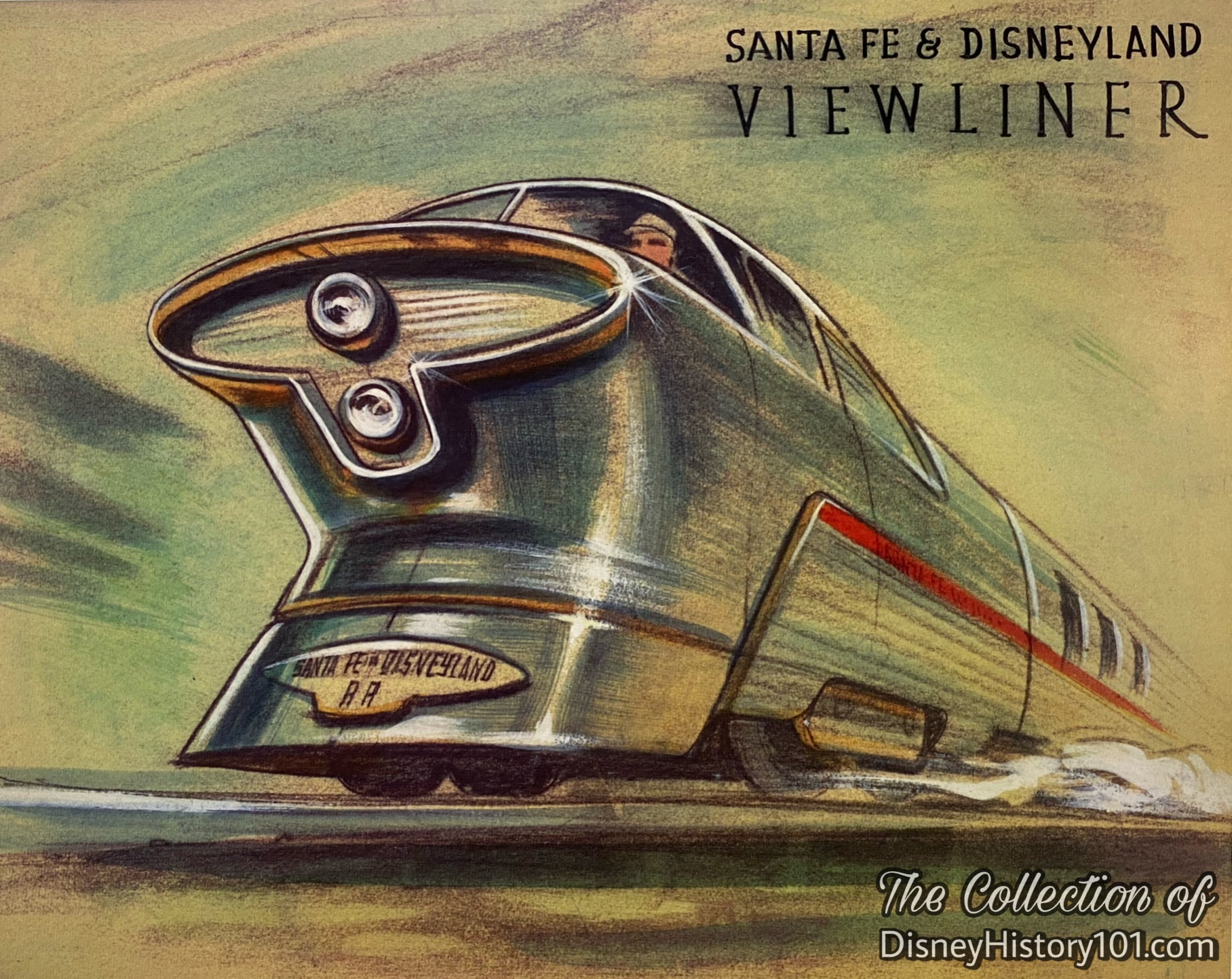
Some of these viable project Concepts (as seen above), were supported by a well-developed business case and built expectation.
Does the body of the Viewliner look familiar? It should, for two reasons. First, artist Sam McKim created some of the earliest concept art of the attraction, inspired by the experimental GM Aerotrain! Did you know that the General Motors Aerotrain was christened (in August of 1955) a month after Disneyland opened? The streamlined electric train was thereafter tested on the rails of the Pennsylvania Railroad and New York Central.
The second reason why the Viewliner may look familiar, is that the cab was comprised of quite a few Oldsmobile parts. The trains were prepared at the Walt Disney Studios Machine Shop.
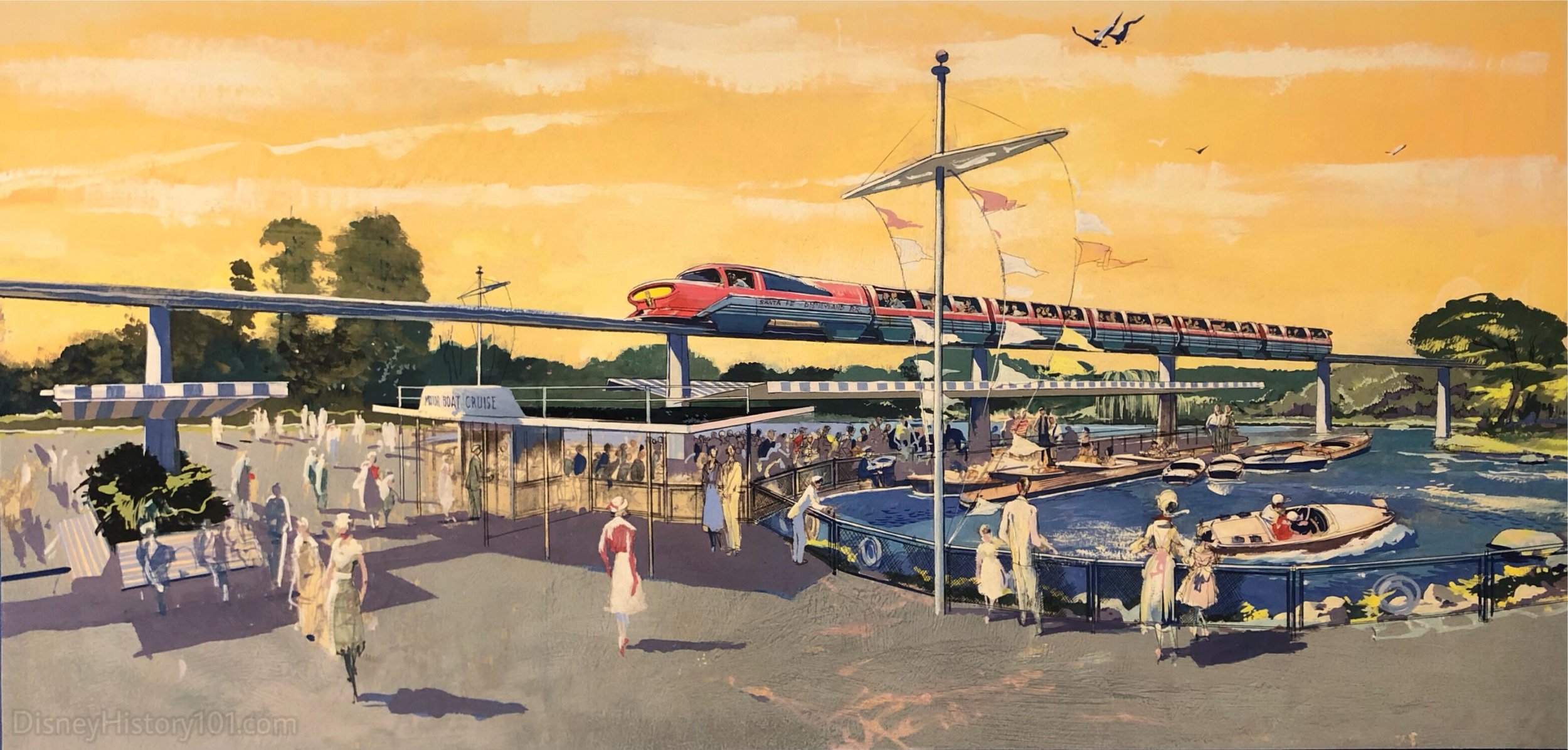
This concept is rarely-seen, published twice to our knowledge. It may have also helped inspire its successor - the ALWEG-Disneyland Monorail! You may notice the influence of the aforementioned Aerotrain on the look of the engine and its stock, and the Viewliner Train of Tomorrow’s elevated tracks over the Motor Boat Lagoon and nautical themed area!
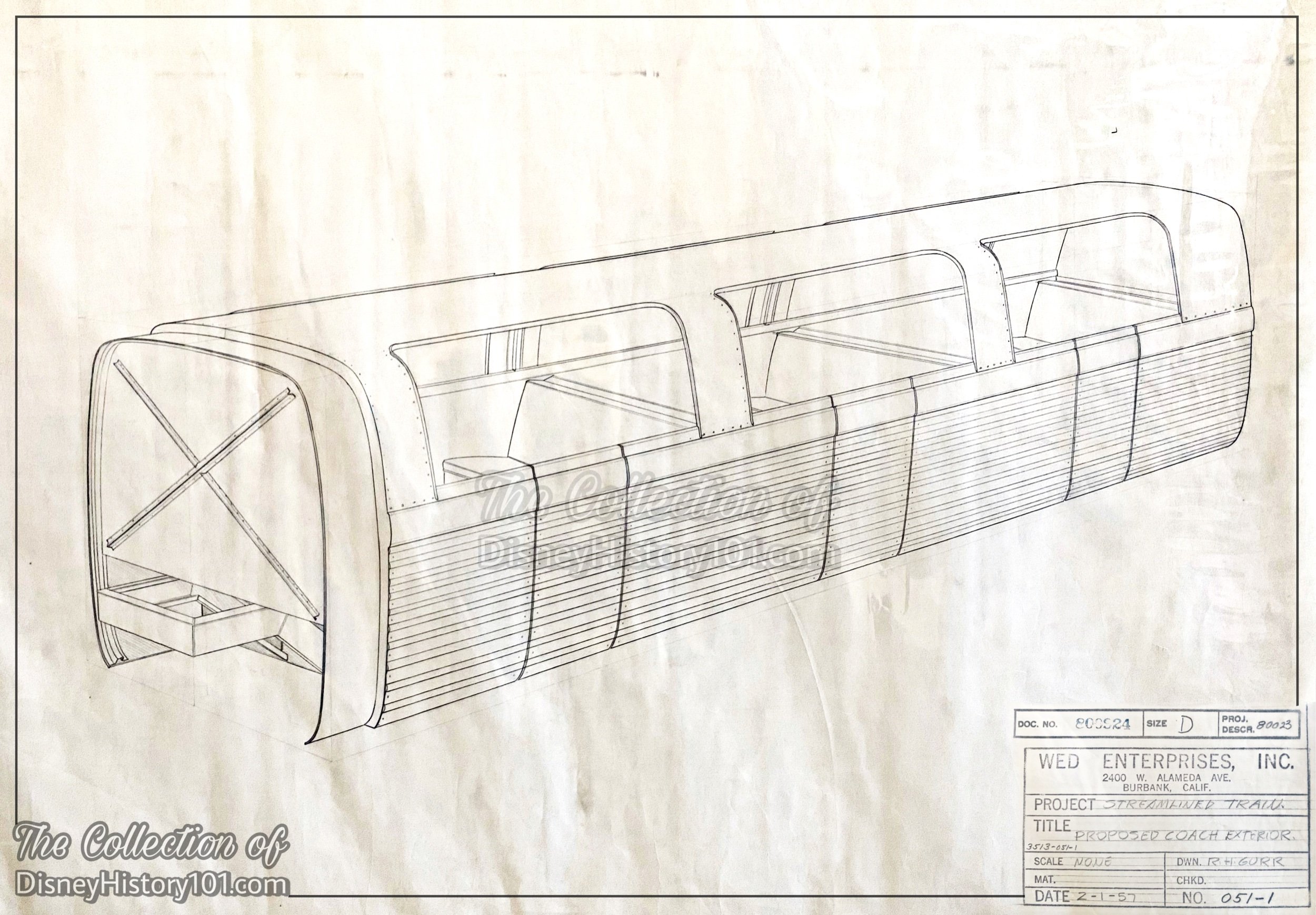
Soon after, Bob Gurr had elaborated upon Herb’s concept, with proposals for “streamlined train” engines and coach exteriors created by February 1, 1957. These were working (construction) drawings and were the final plans from which the attraction was built.
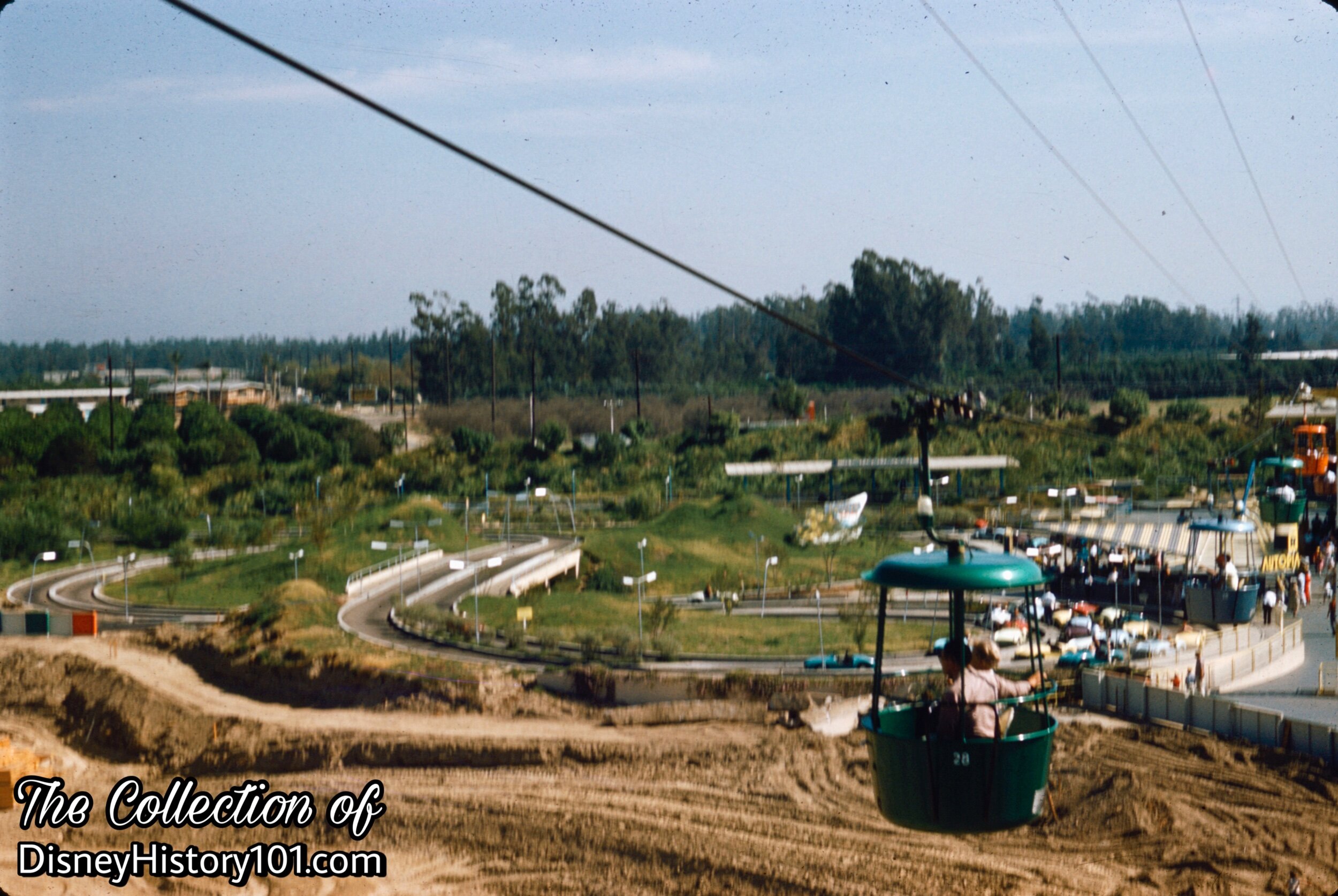
In order to lay the rails, the land was “graded” (or, leveled), and then construction began on the rails. According to Michael Broggie : “Rails were spiked atop plates into five-foot-long wooden ties, themselves treated with creosote and seated in rock ballast. As a safety feature, the track’s block-signal system could apply the brakes electronically if a train ran through a red signal.” Joe Fowler (Disneyland Operations Committee) oversaw the Construction & Maintenance division including Engineering, New Construction, Maintenance, and Janitorial related to the installation of the attraction.
This narrow-gauge railroad layout would be of the most expensive Disneyland attractions to date! The authorized construction costs of the attraction were divulged in expense reports :
•$53,264.88 (for two engines)
•$81,202.40 (for all 10 coaches)
•$33,521.48 (for track, ties, and bed)
•$20,748.40 (for the trestles)
•$13,411.32 (for the block signal system)
•$1,981.70 (for the P.A. systems for the stations)
Yes, at $204,130.18, the Viewliner was truly one of the most expensive Disneyland attractions by 1957! Once complete, each 5,000-pound locomotive was unloaded onto the rails with the help of a crane.
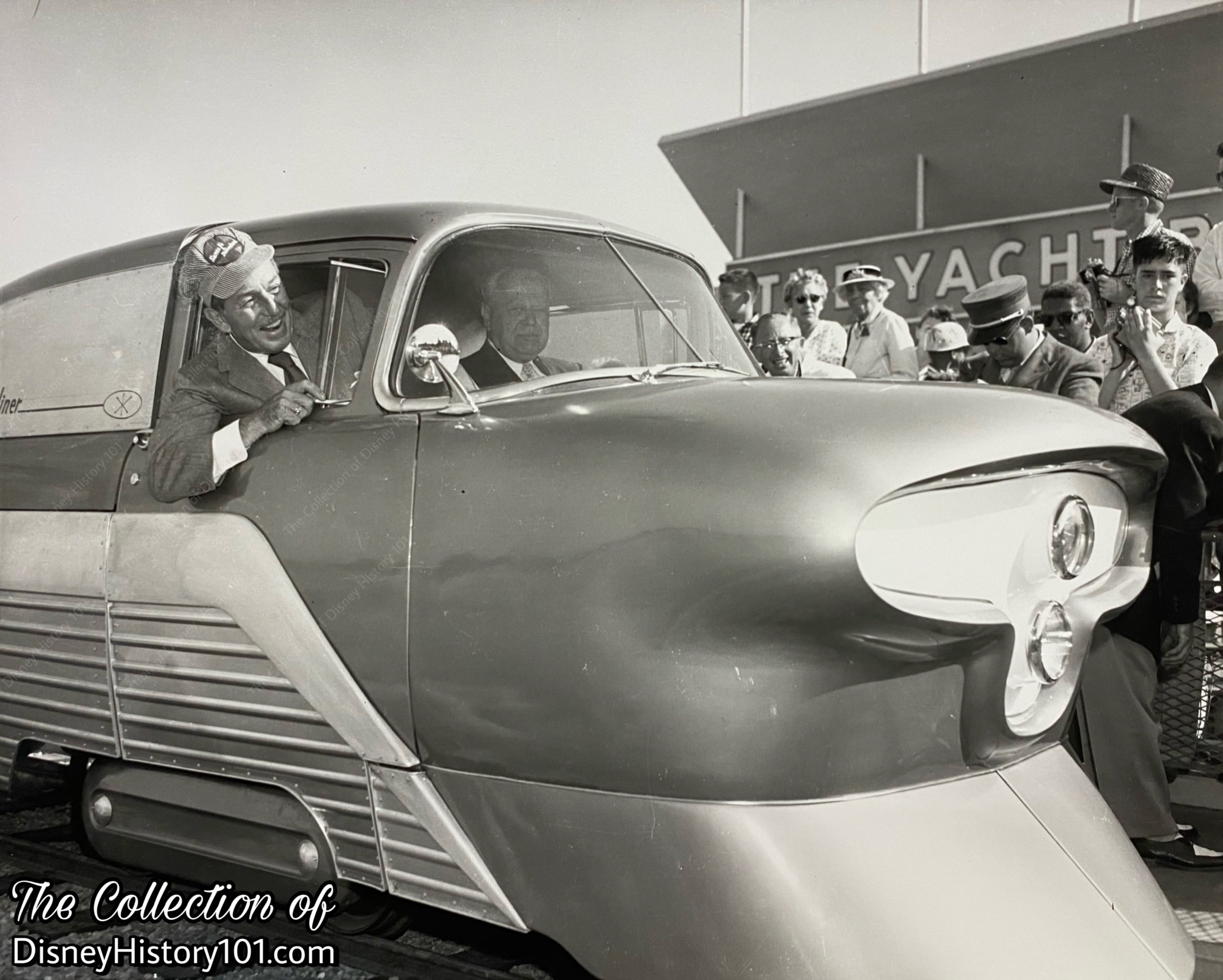
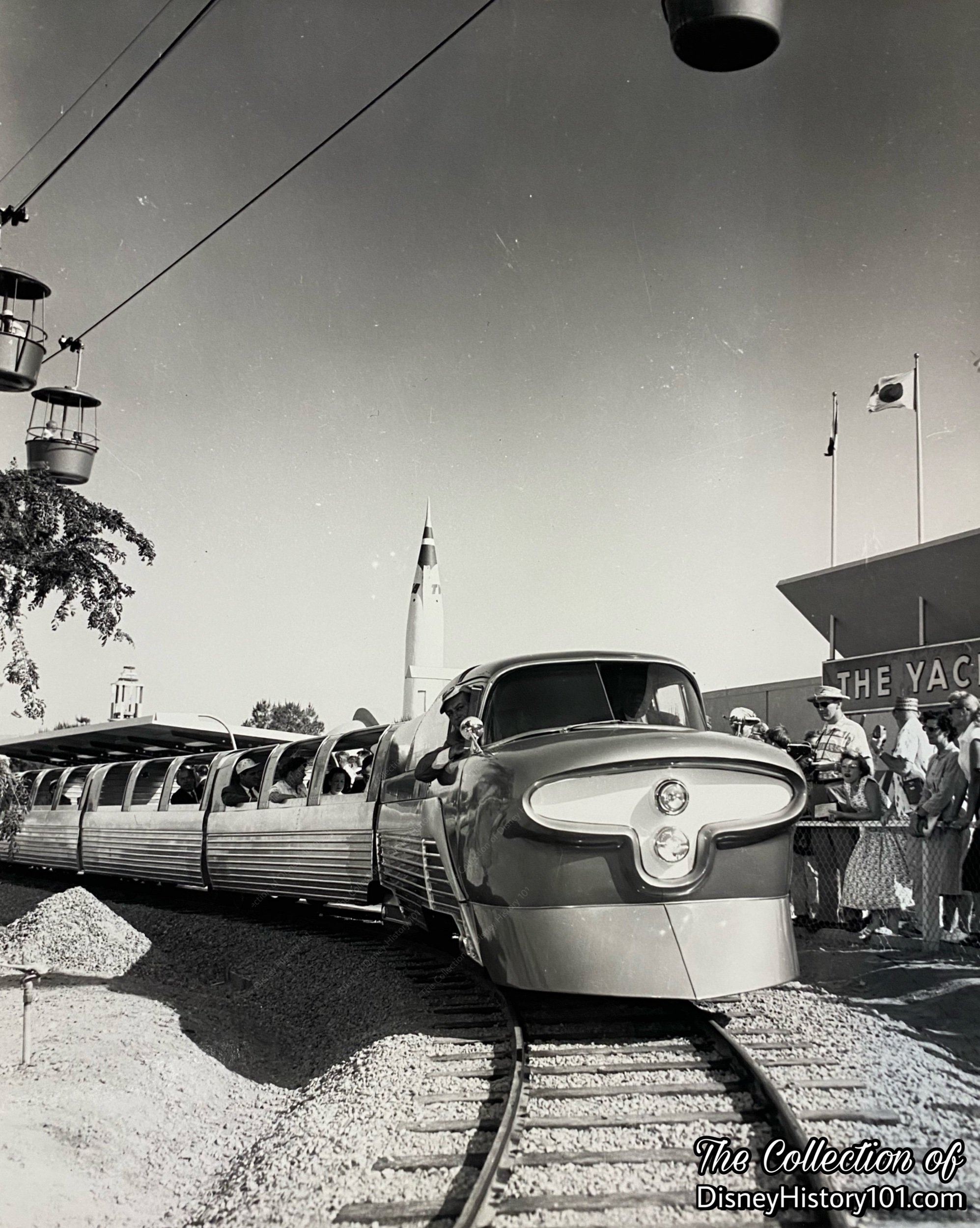
“55er” Joyce Belanger recalled: “On opening day for the view liner, Walt was at the controls. There were some beautiful new flower beds at the station and as everybody crowded closer and closer to see Walt, they got into the flowers. This kinda bothered Walt a bit and he asked the people to ‘Please keep off the flowers!’”
Bob Gurr also attended the opening and dedication, dressed in an Engineer ride operator costume.
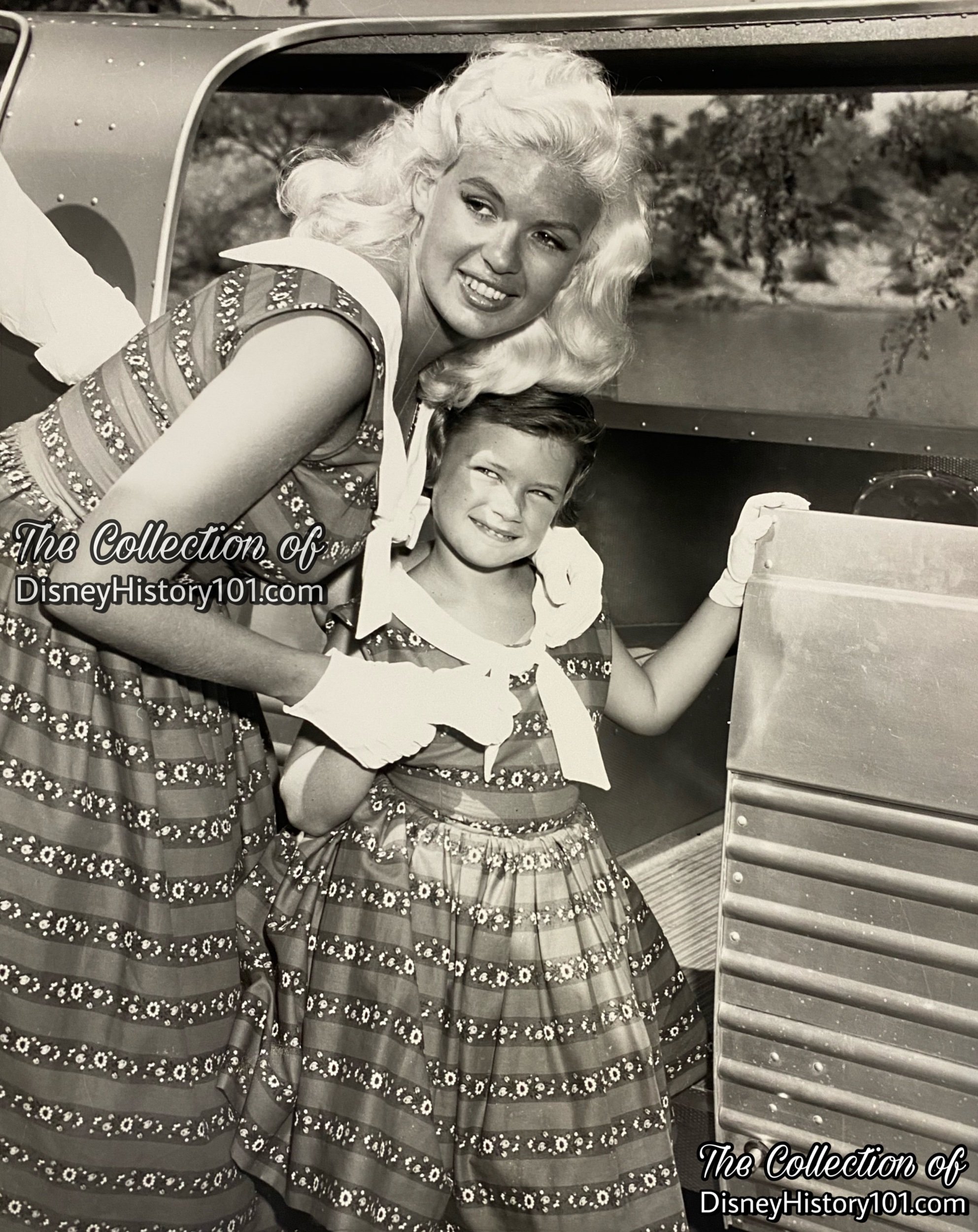
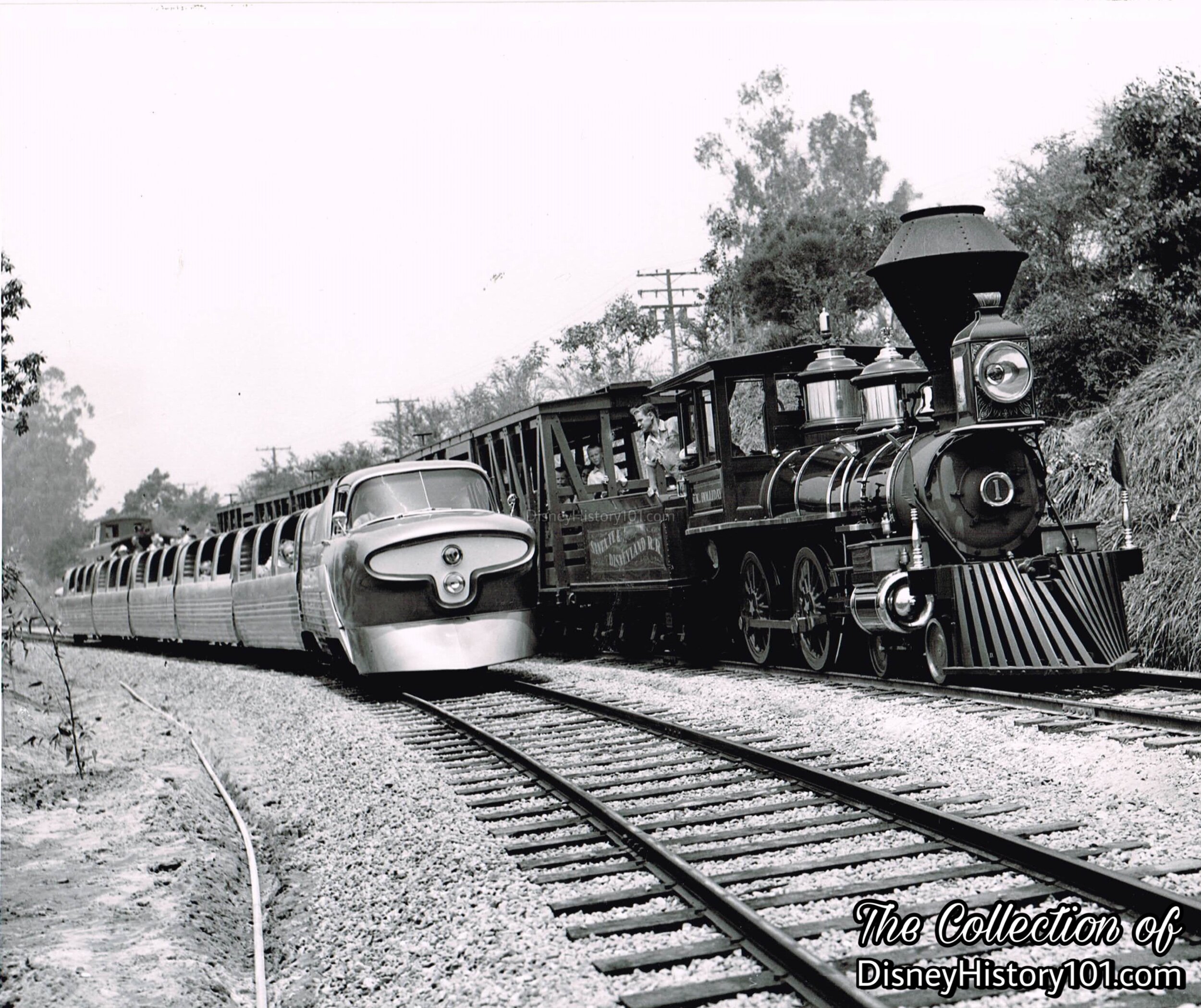
“Railfans” (and automotive fans) would appreciate that each of the 18’4” Viewliner engines were a 0-4-4-0 (8-wheel drive) type engine, weighing 5,000 pounds, and powered by a modified 1954 Oldsmobile 88 gasoline-powered engine! The Viewliner engines had an automatic transmission, drive shafts, and differentials. Where the full-scale Aerotrain would move at speeds of 120 miles per hour, the Viewliner (capable of speeds of 60 miles per hour) operated at comparative speeds of 30 miles per hour in Disneyland. As a “sidelight,” “at an actual ground speed of 30 mph, the Viewliner speedometers registered 120,” according to Michael Broggie (in Walt Disney’s Railroad Story”). According to “Walt Disney’s Railroad Story” by Michael Broggie (page 297), this may have been owning to the fact that “each car featured two speedometers… calibrated to register four times the train's actual speed.” Regardless, this was all very impressive considering the attraction’s narrow 30-inch gauge rails, rails that ran around and over Tomorrowland Lake!
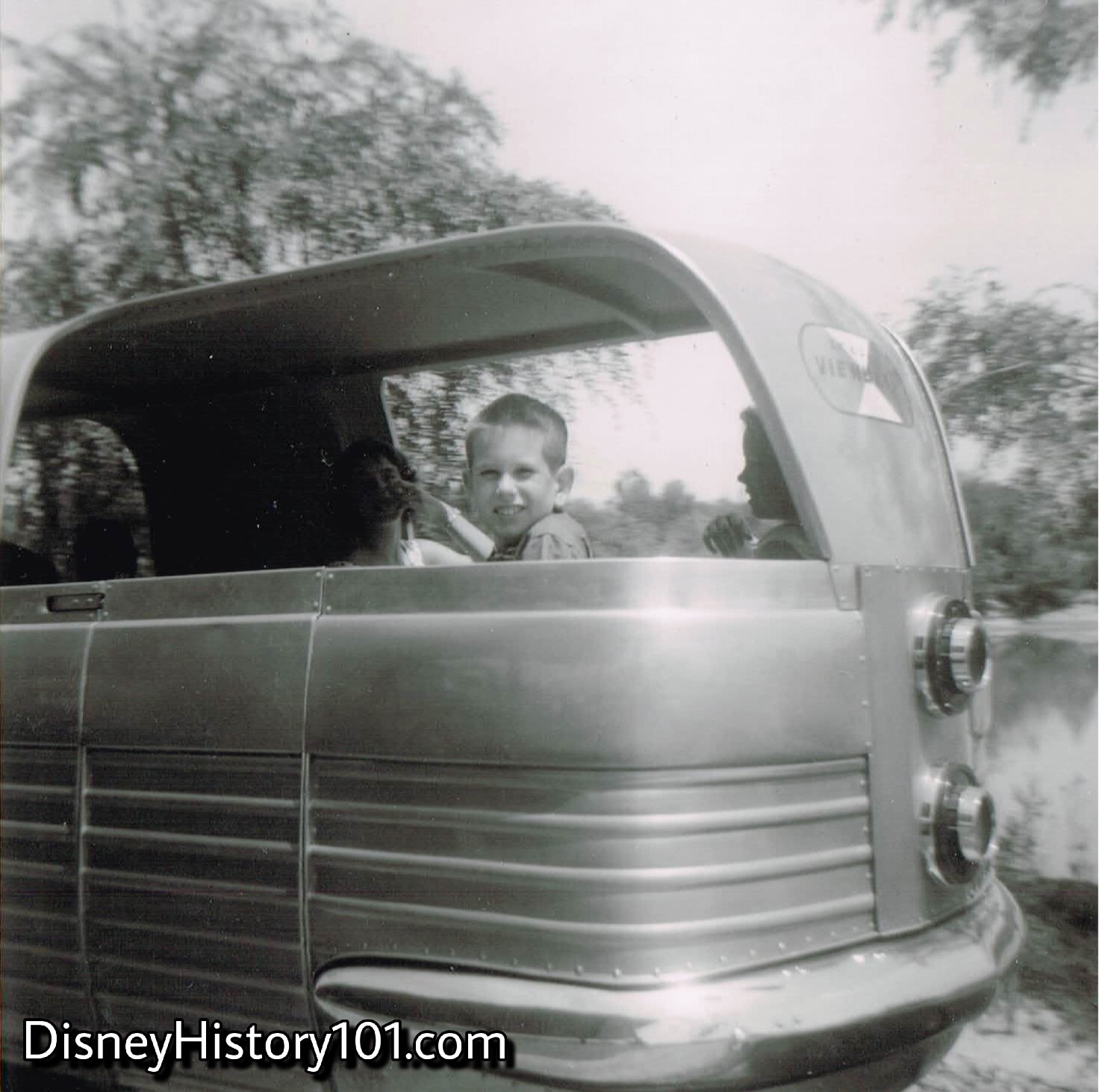
During its “peak” attendance periods of its short heyday, the Viewliner was often operated by a maximum of 2 engineers, 2 ticket takers, 4 platform men, and 2 relief men.
The attraction had two 32-seat trains with an average total guest capacity of 12 (for the passenger cars), and 16 (for the observation car). Guests sat inside the comfortable and modern 2,000 pound aluminum and steel-frame passenger coaches or observation coach of each train. Pictured above, one of the Tomorrowland Viewliner’s younger passengers enjoys the view from one of the best seats!
Communication speakers allowed the engineer to make announcements. Automatic electric doors (also controlled by the engineer), and vacuum operated brakes (on every wheel) kept the guests safe inside the coaches for the duration of the ride. The 16’10”-long Coaches (like the engines) featured standard automotive parts (particularly, General Motors components within their suspension assembly), a gimbel bearing connection, and two speedometers.
The names of the two train engines (and their rolling stock) were :
•Tomorrowland Viewliner - and passenger cars Jupiter, Venus, Mercury, Mars, and observation car Saturn.
•Fantasyland Viewliner - and passenger cars Pinocchio, Cinderella, Bambi, Alice, and observation car Tinkerbell.
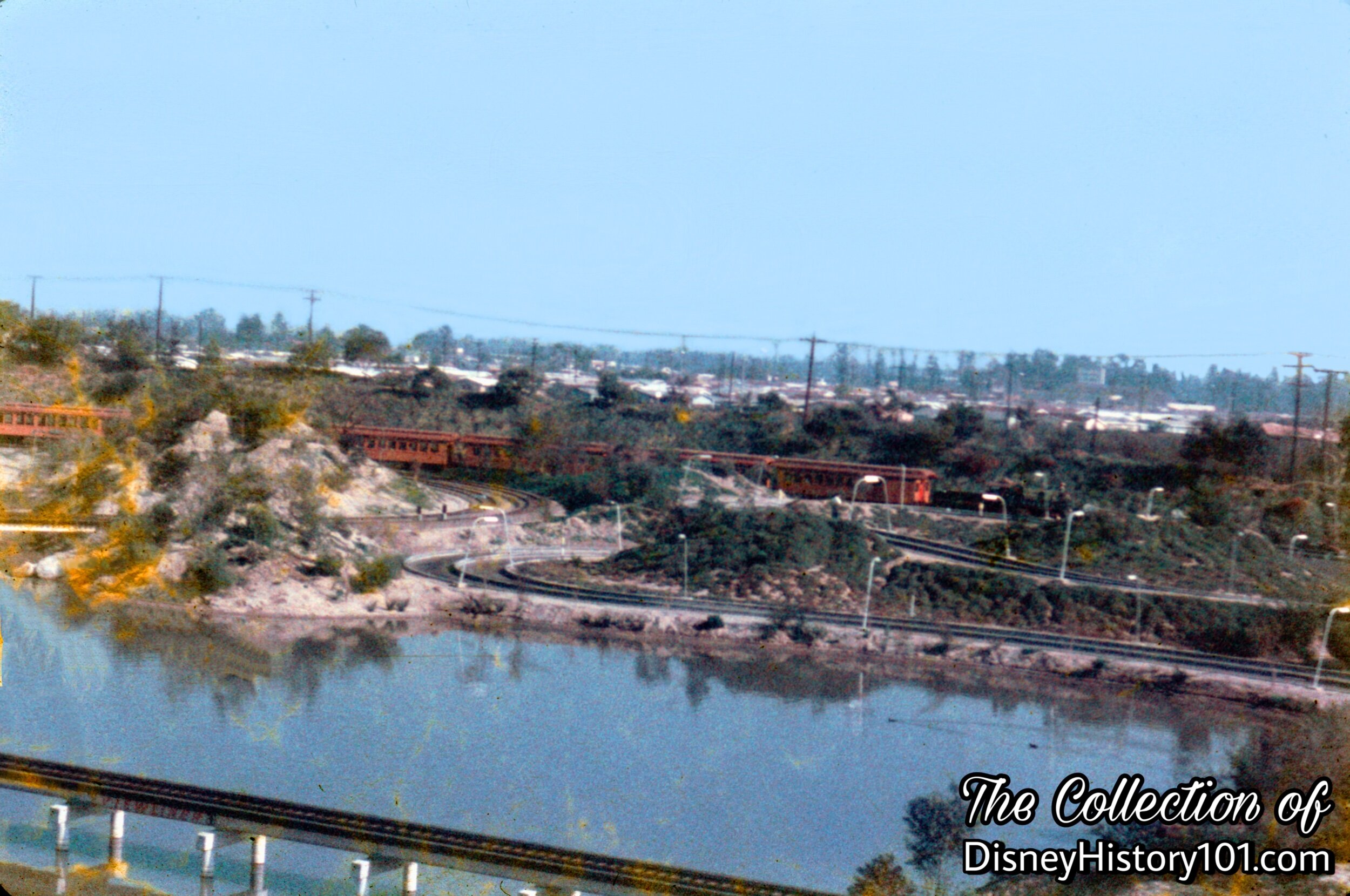
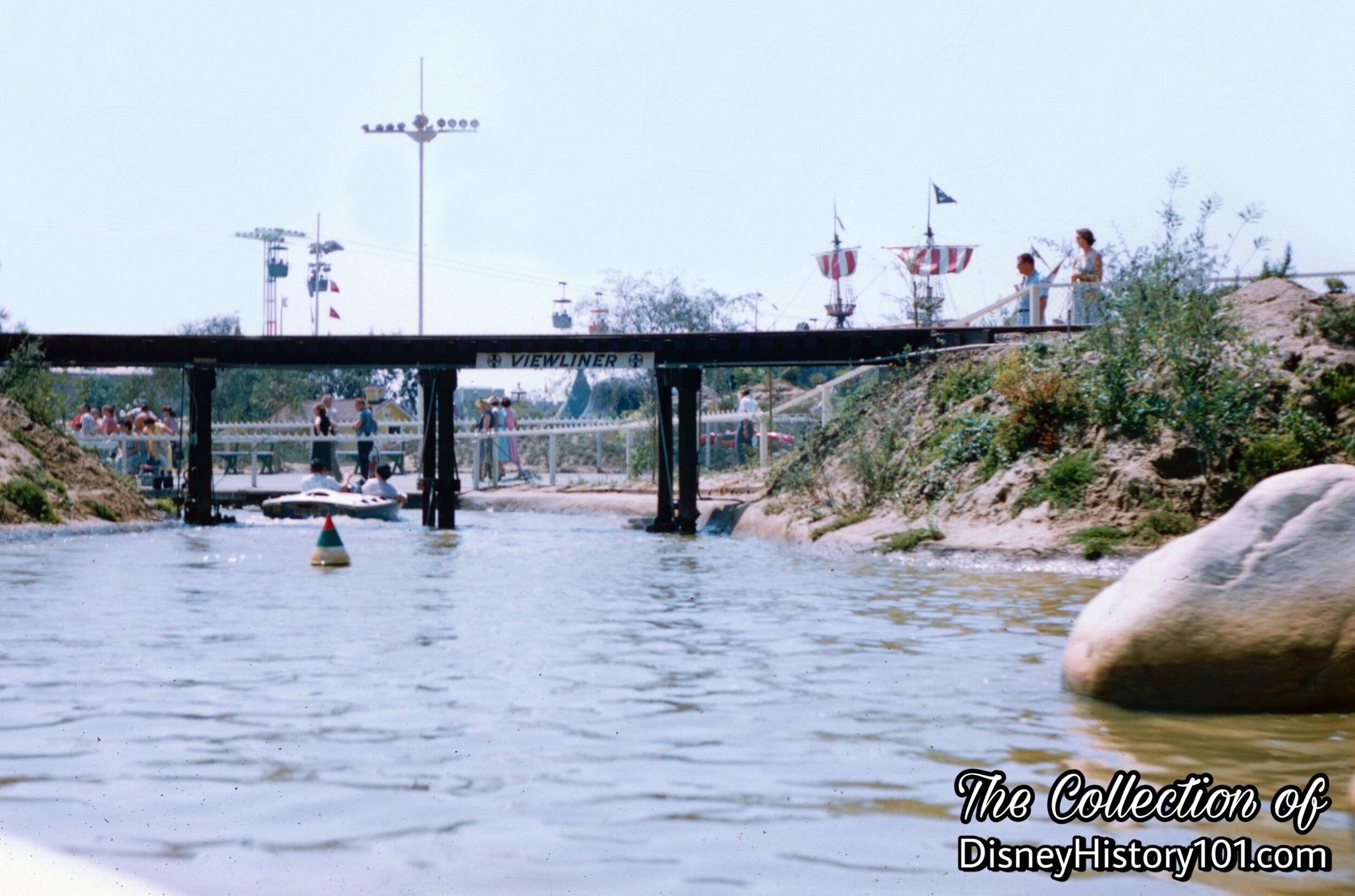
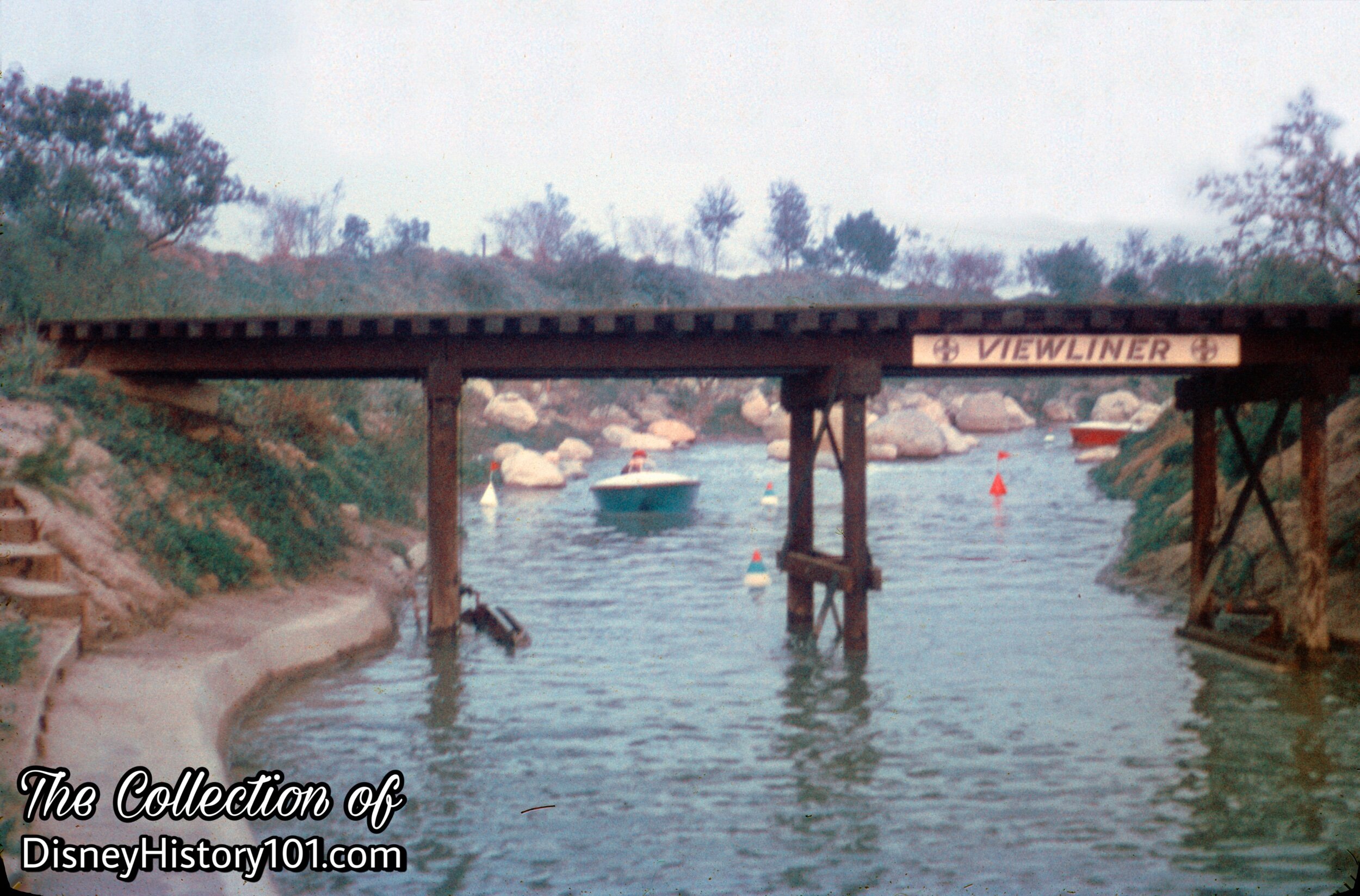
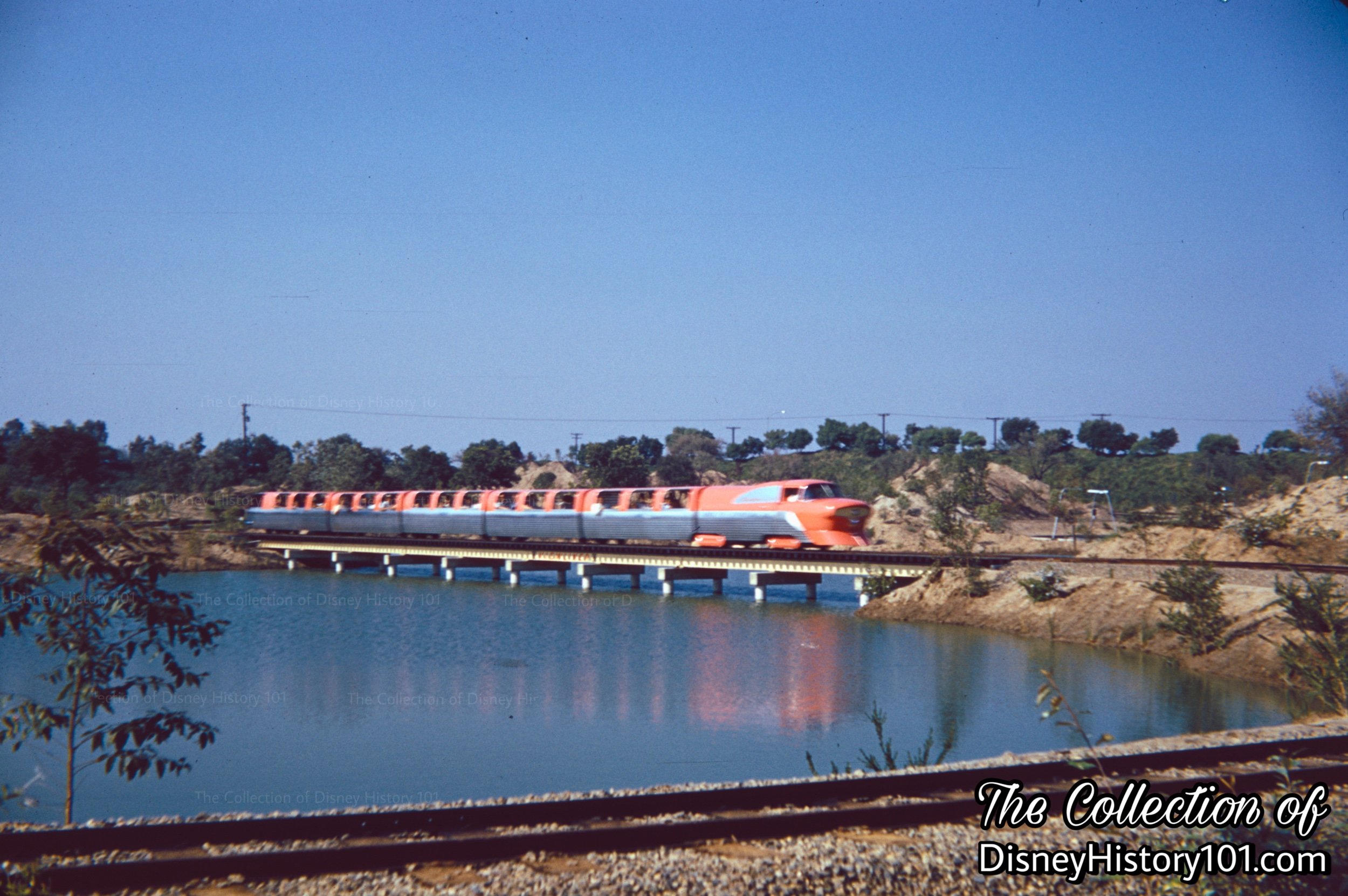
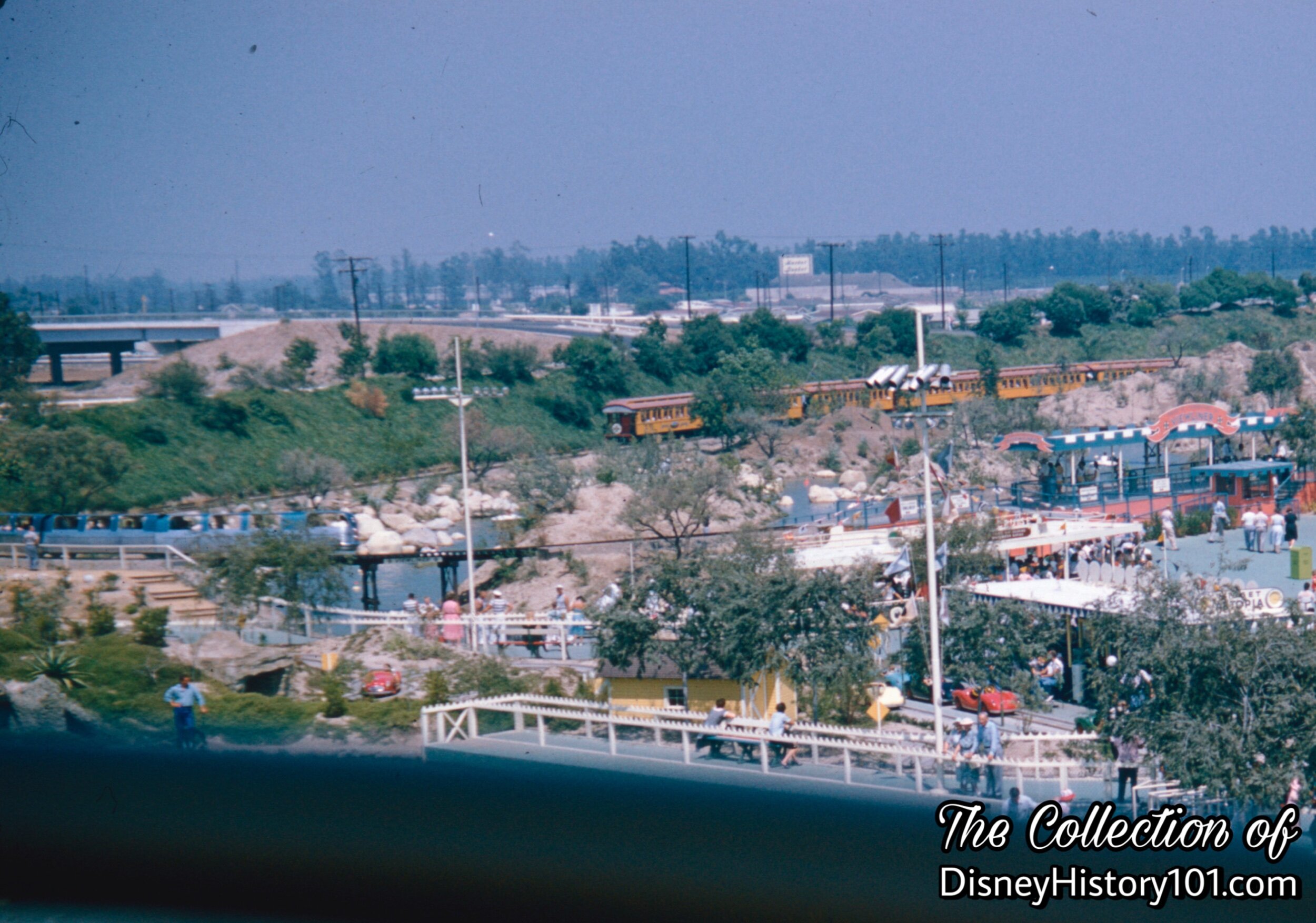
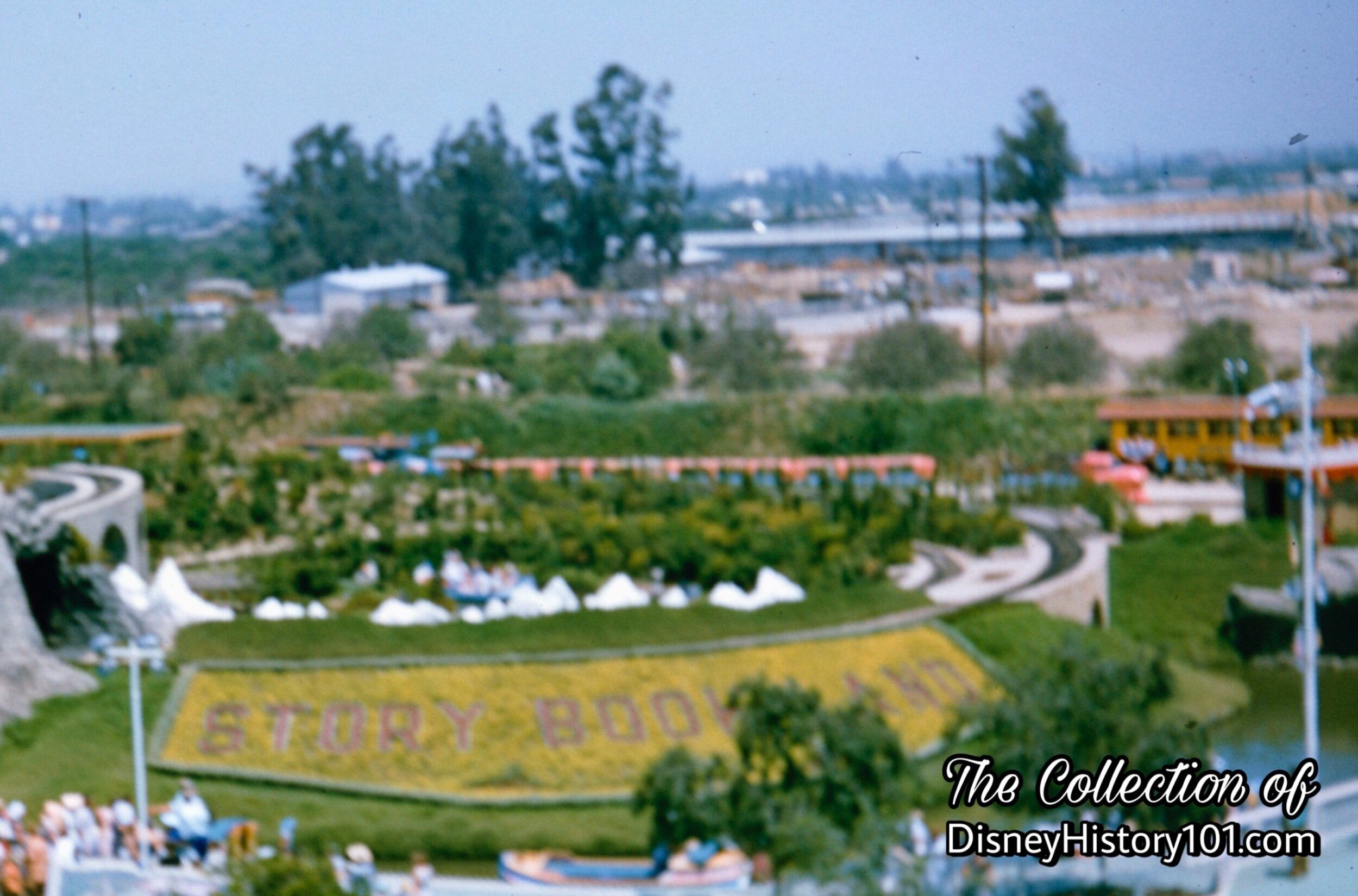
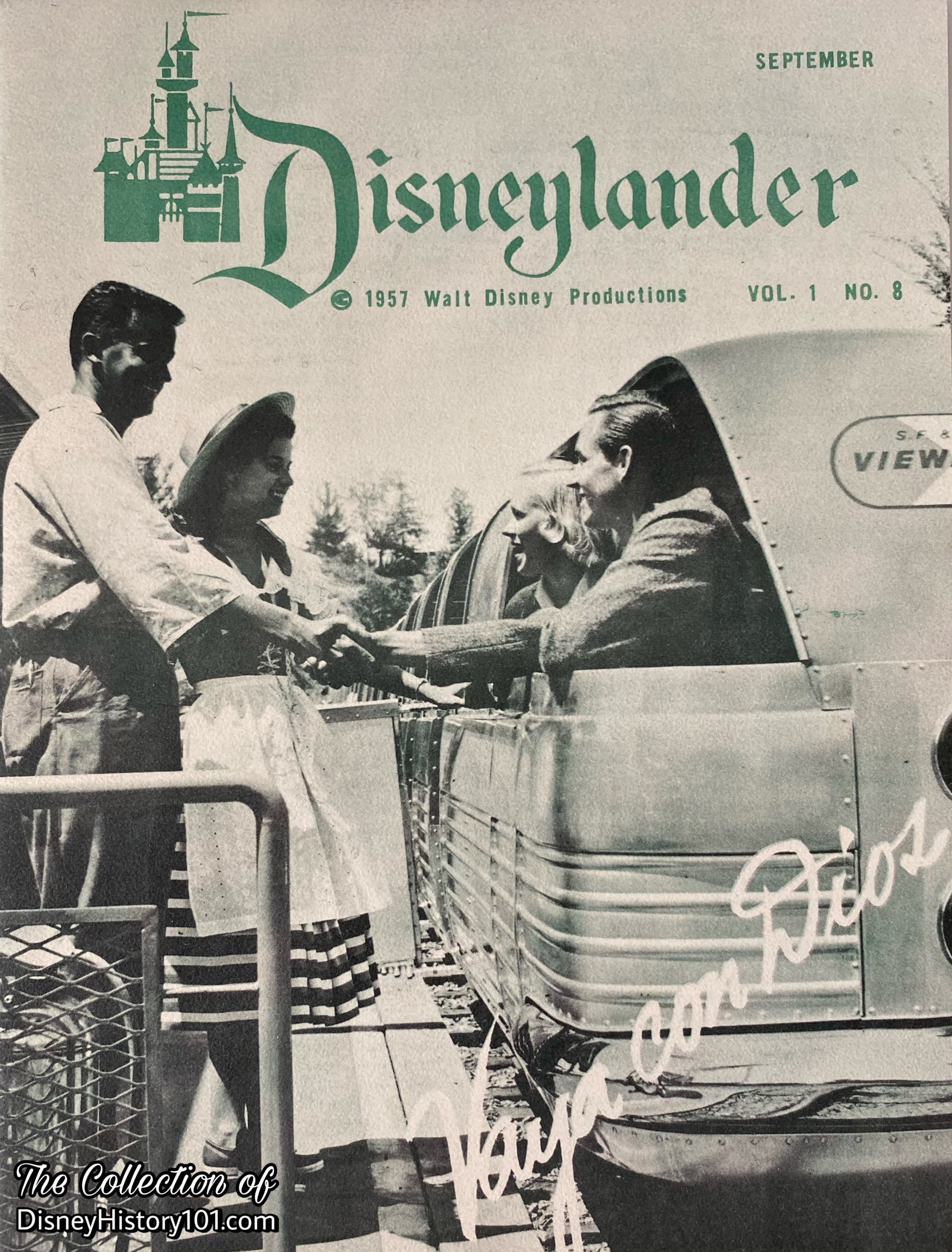
A fond farewell is issued to a couple of Disneylanders aboard the Viewliner on this cover of Disneylander. Little did anyone know that they would be bidding “Vaya con Dios” to the Viewliner a year later.

Admission for the 3-minute trip aboard the Fantasyland Viewliner or Tomorrowland Viewliner was one “B” Admission Coupon (or, 25 cents, for one adult), the same as a round of ammunition in the Main Street Shooting Gallery, entry into the Mickey Mouse Club Theater, or a ride aboard the Conestoga Wagons in Frontierland! This translated into the Santa Fe & Disneyland Viewliners yielding total revenue (in management fees for Disneyland Inc.) of $19,594 for the fiscal year (52 weeks) ending September 29, 1957 and a total of $35,524 for the fiscal year (52 weeks) ending September 28, 1958.

Soon after its grand opening, the Viewliner Train of Tomorrow (with Walt at the controls) was amazingly preserved on film in the “An Adventure in the Magic Kingdom” episode of Walt Disney’s “Disneyland” television series (filmed during “Walt Disney Studio Day at Disneyland ” in 1957, and airing on television in 1958)!
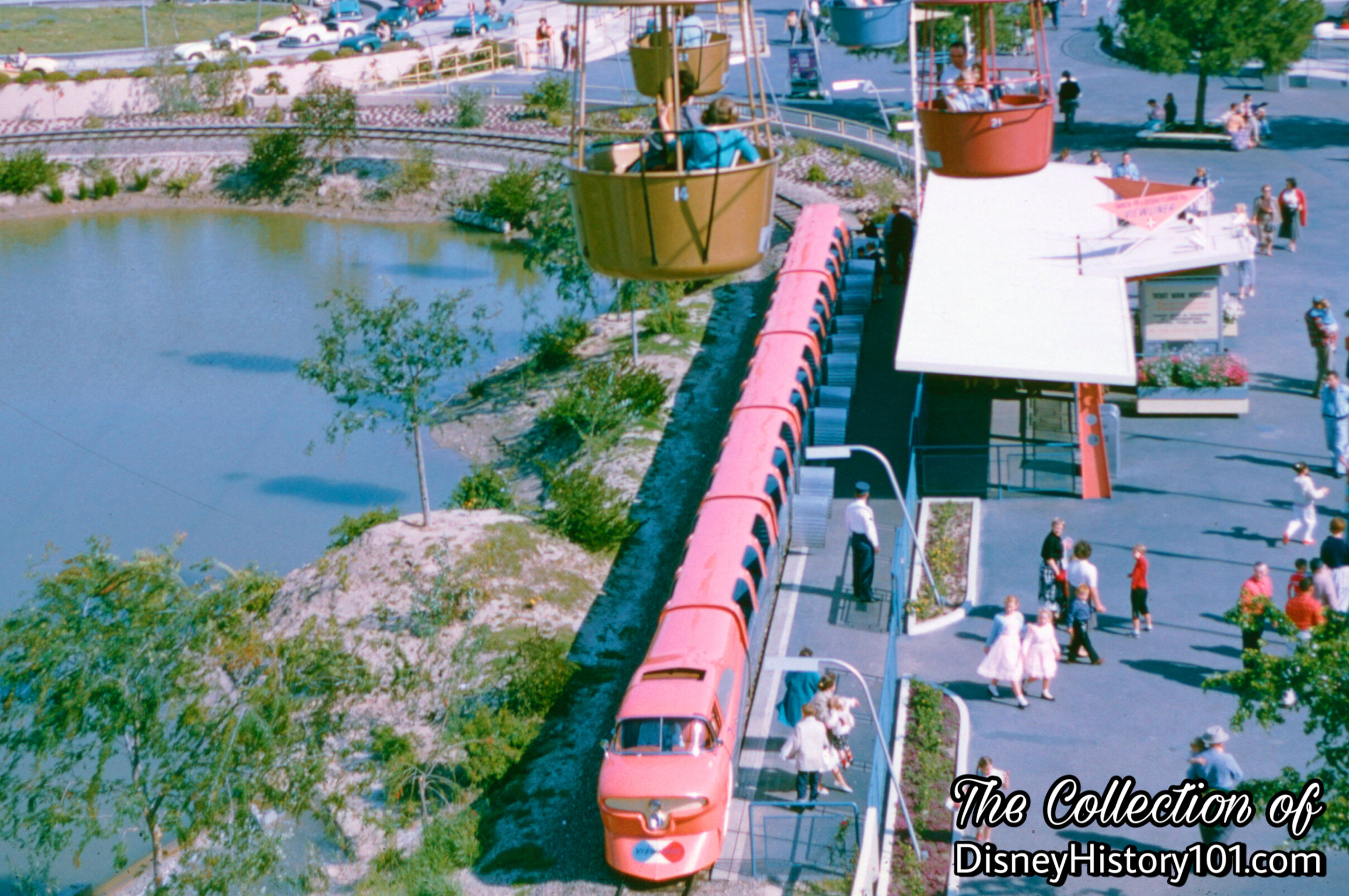
All together, each 96’8” Viewliner train could easily pull in alongside one of two stations (each, with a 109-foot loading platform) - one in Fantasyland and the other in Tomorrowland (pictured above)!
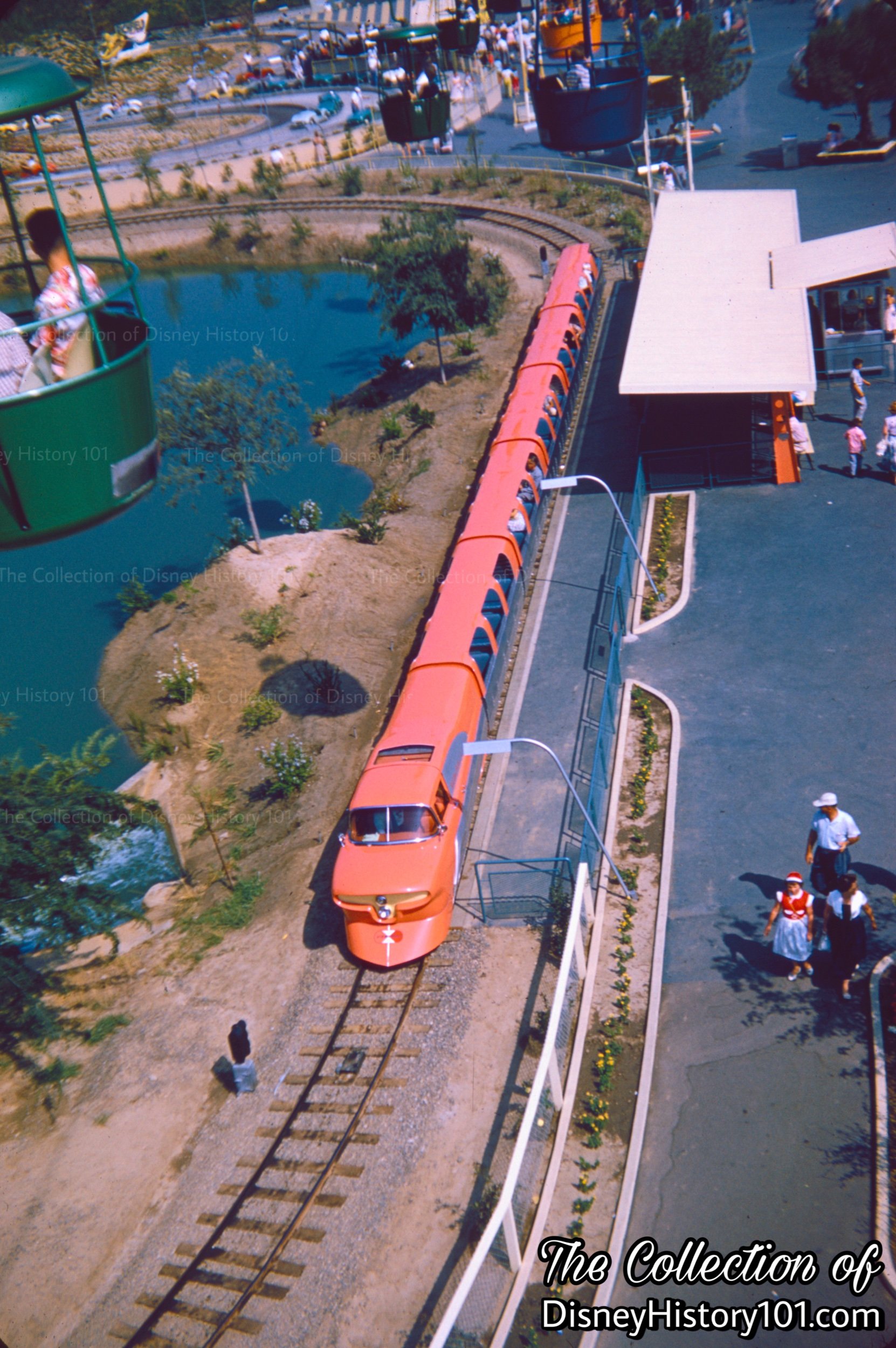
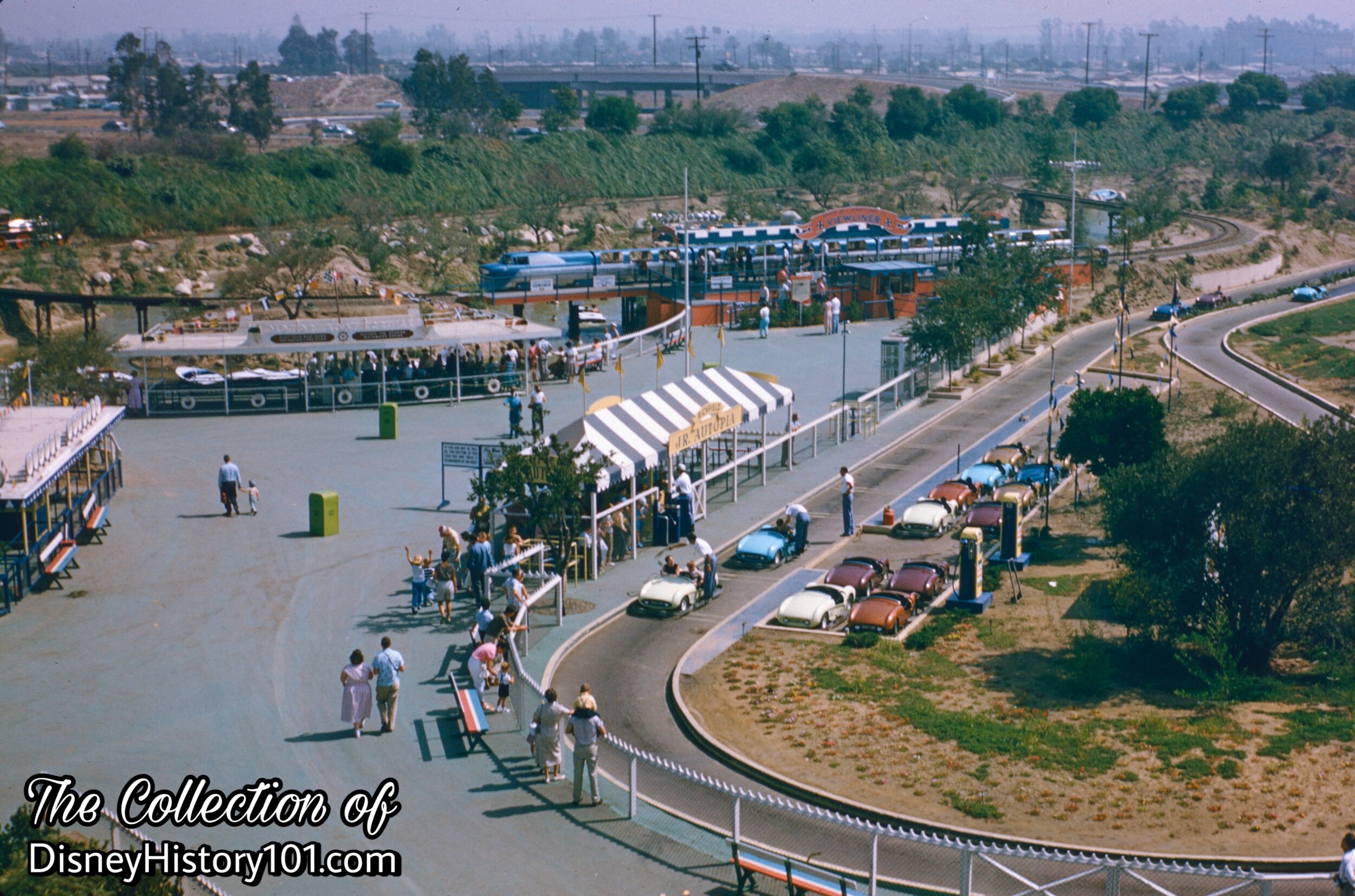
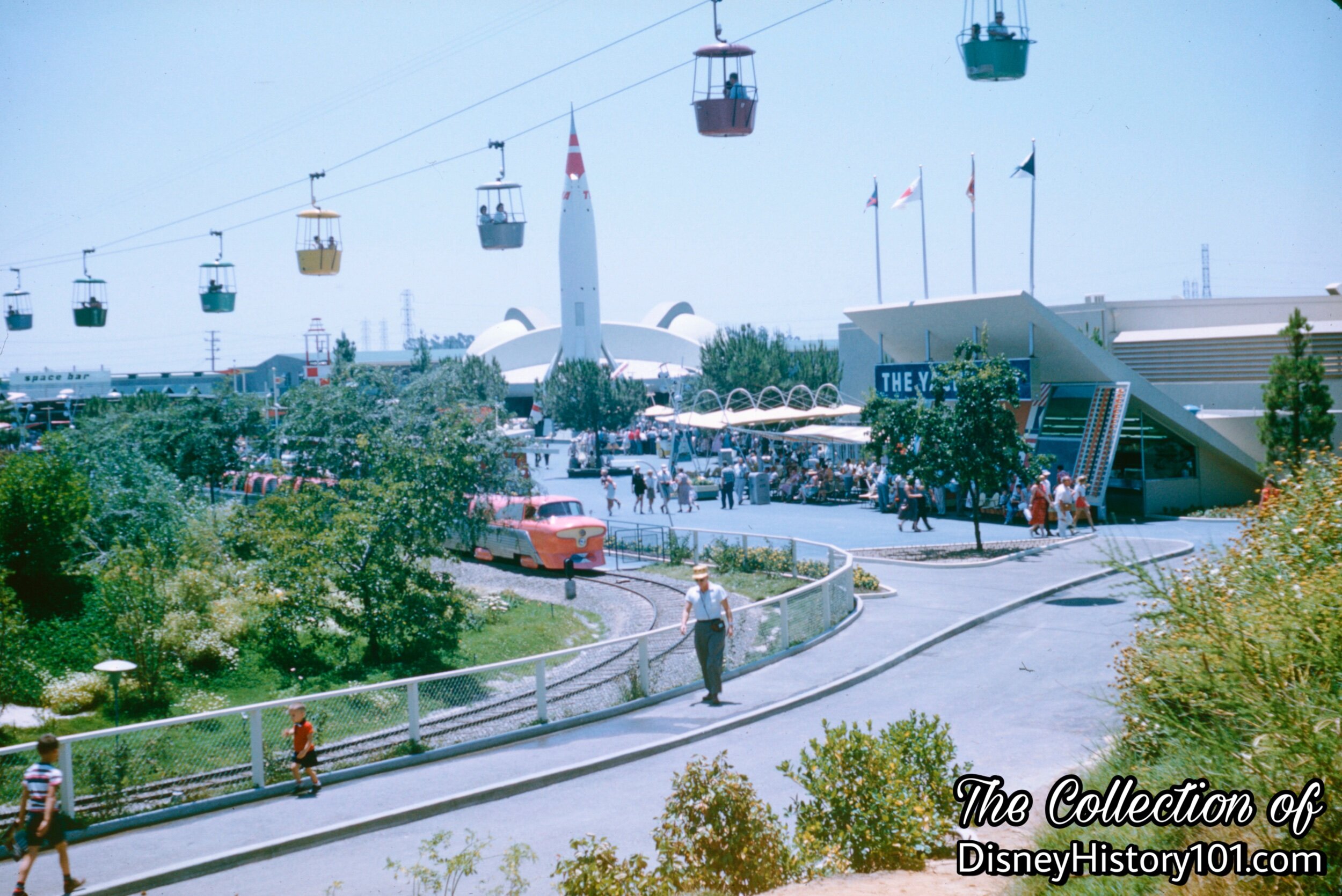
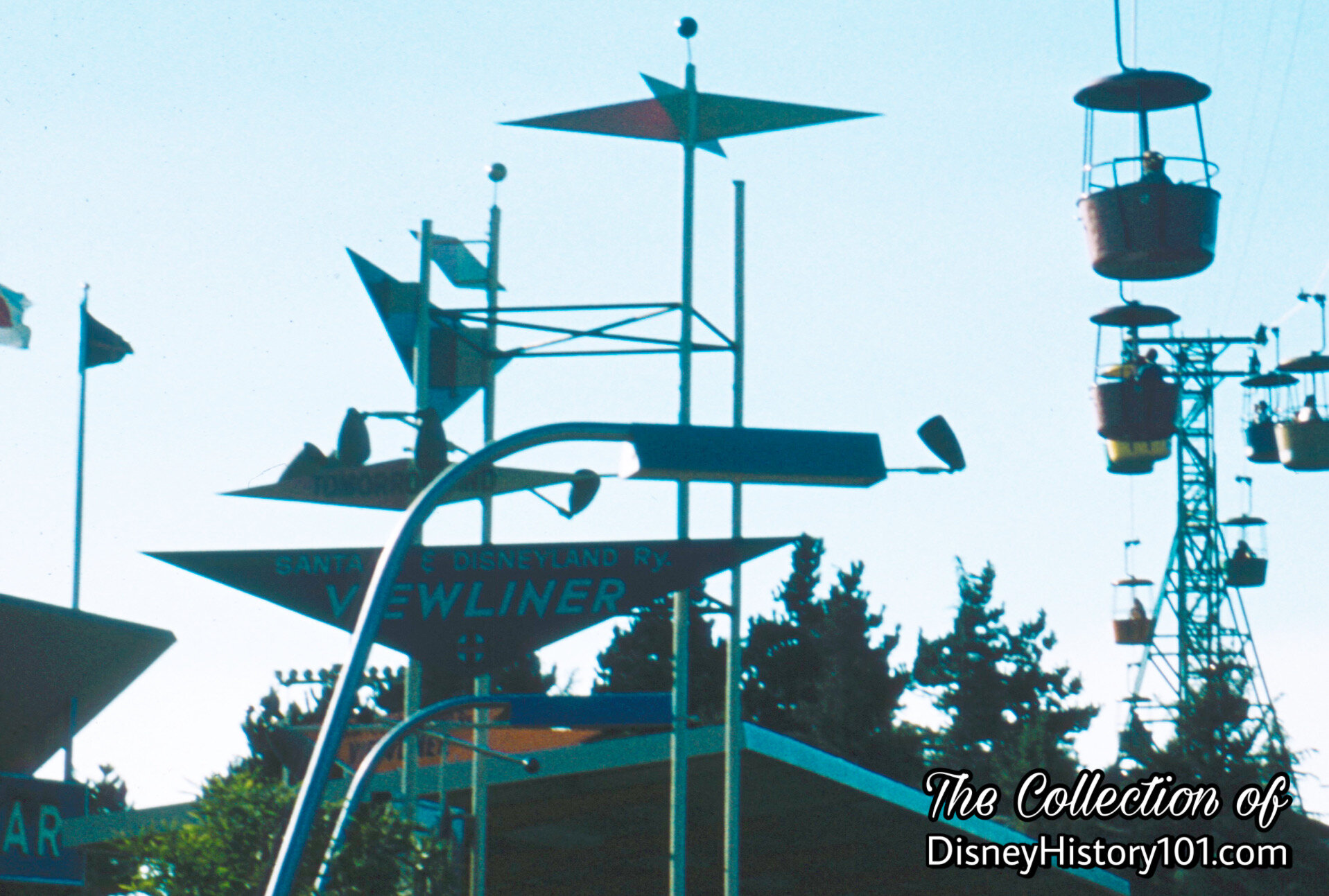
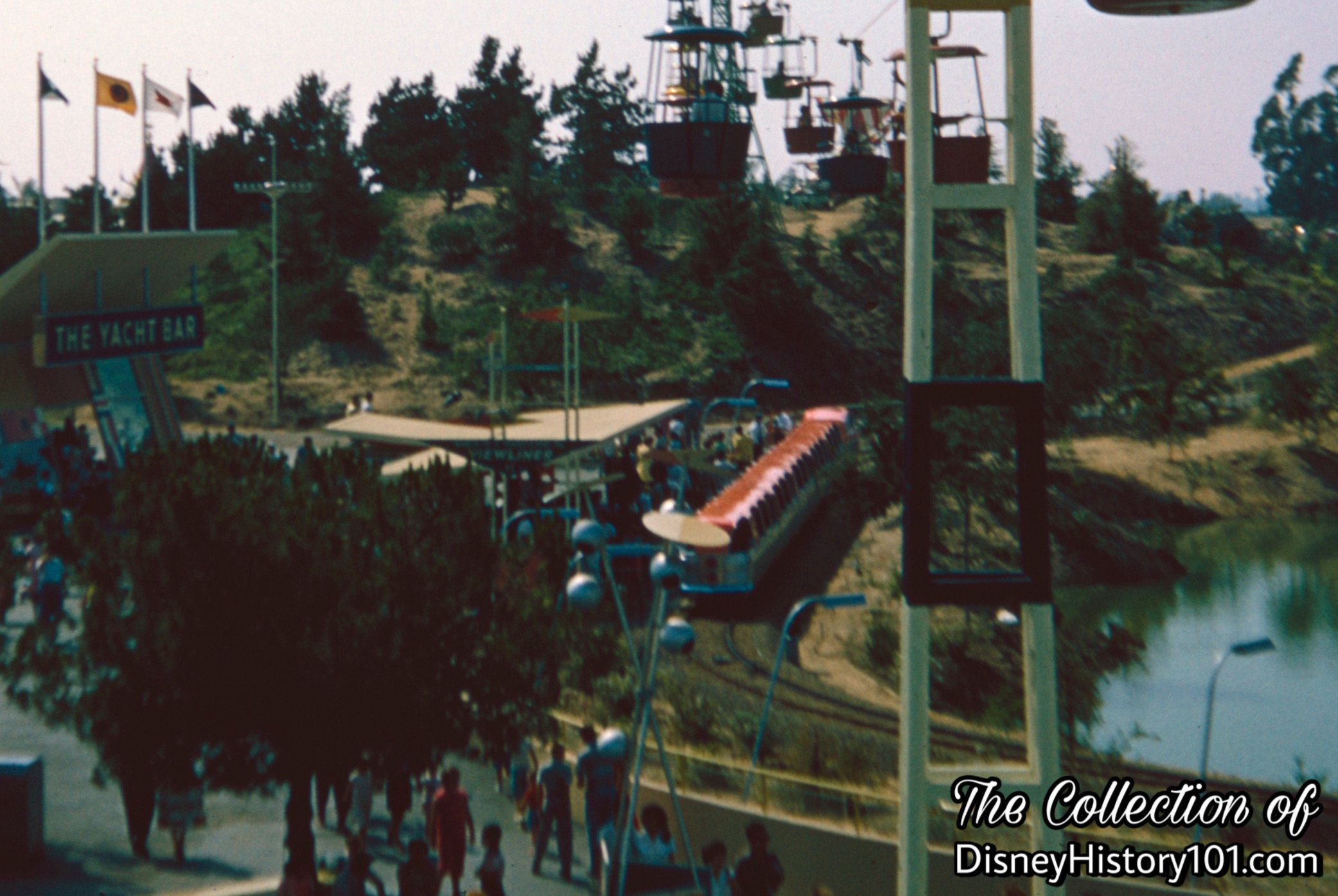
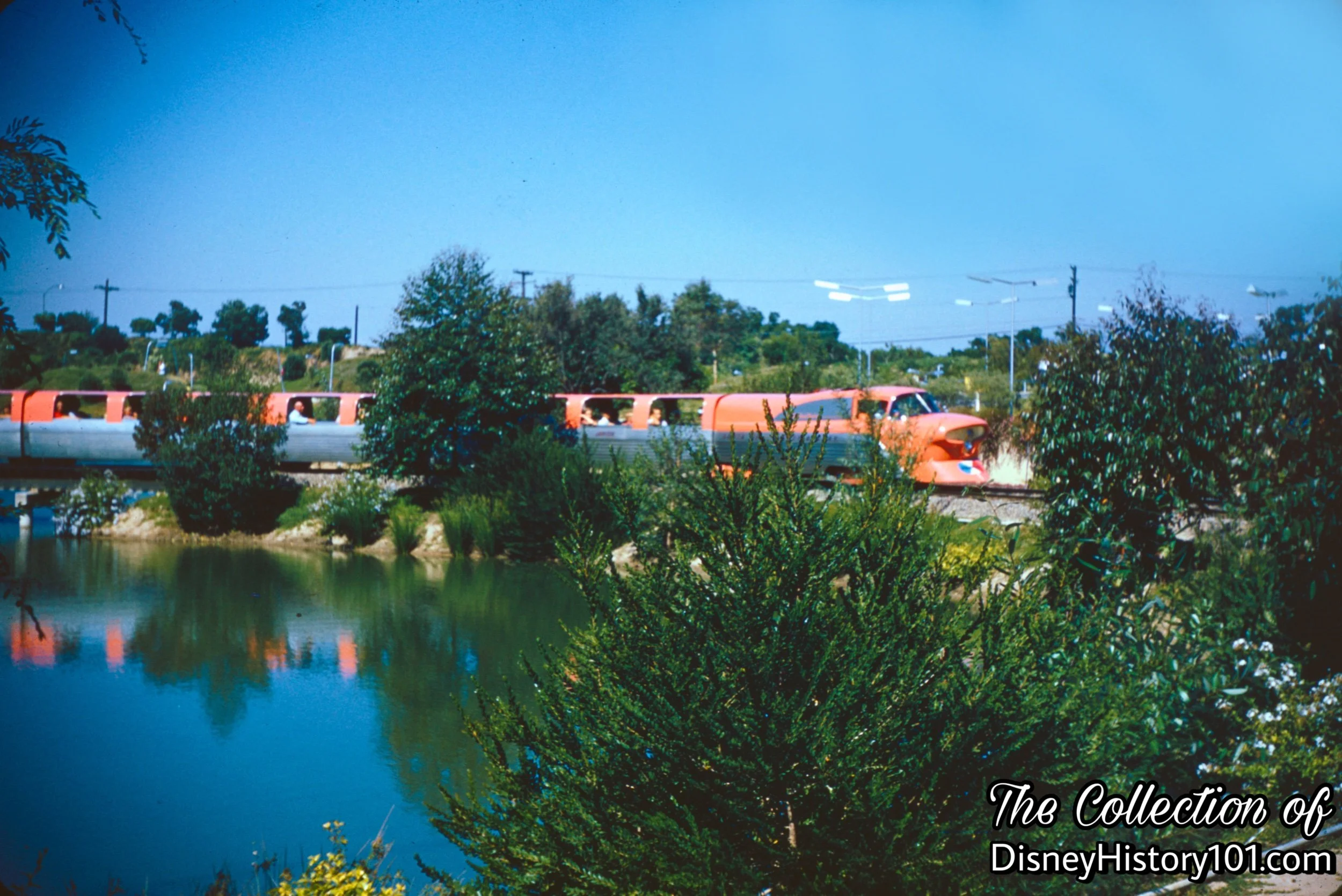
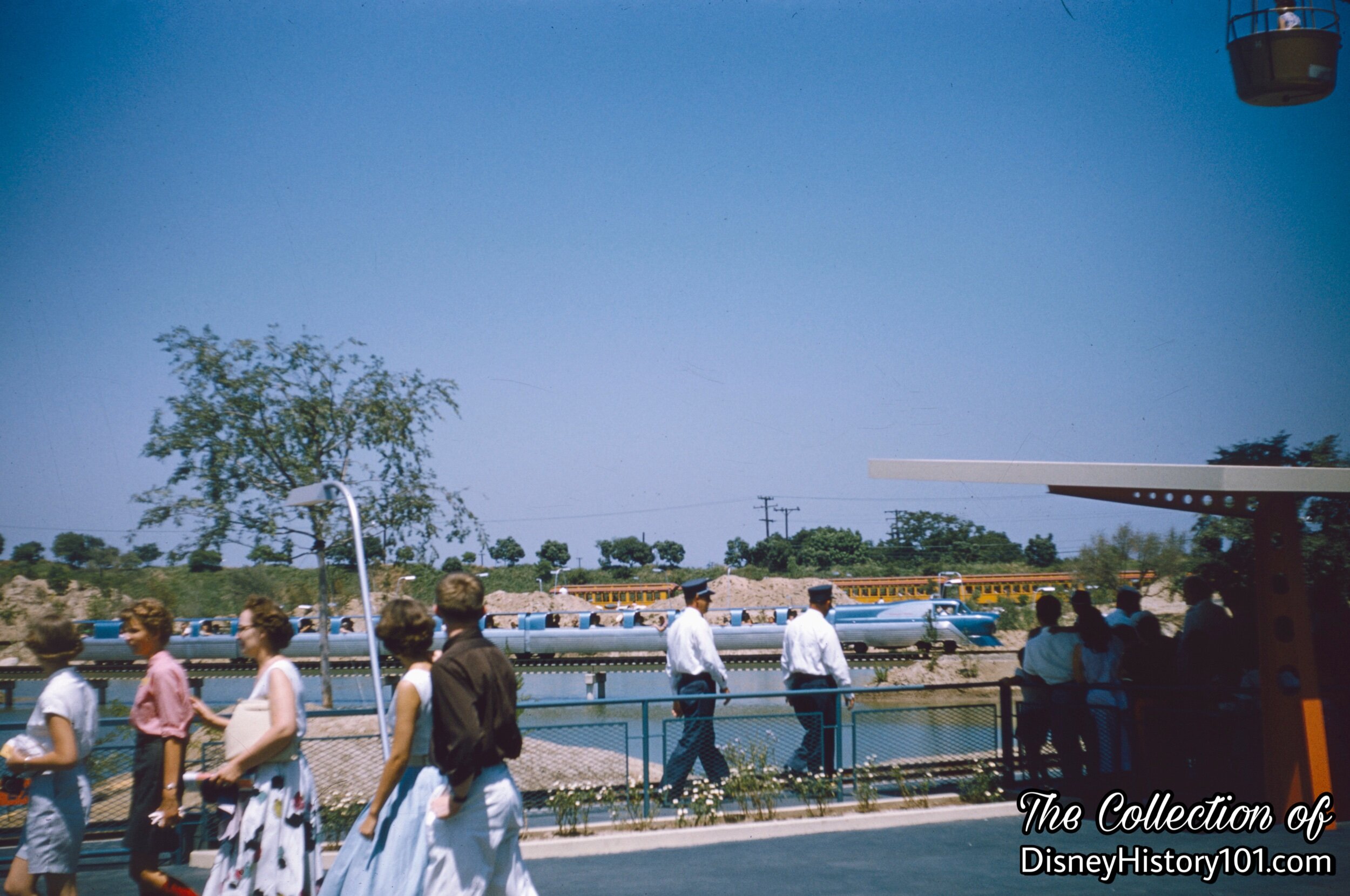
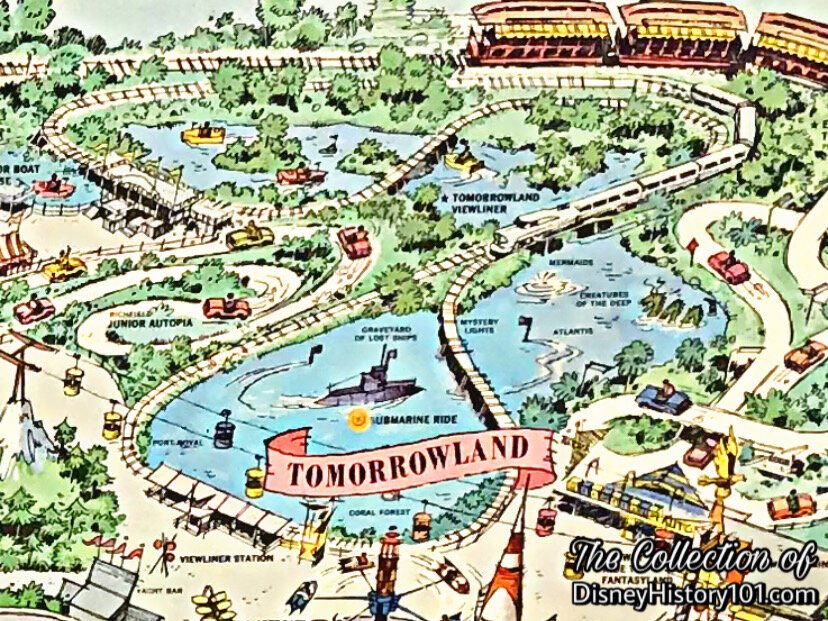
By the details of 1 (of 3 of) Sam Mc Kim’s c. 1958 Disneyland Wall Map (“1958 A”), it appeared that the Viewliner’s tracks and trestles were to run over the tides of Tomorrowland Lake and the “Submarine Ride” (with its “Coral Forest,” “Port Royal,” “Graveyard of Lost Ships,” “Mystery Lights,” “Mermaids,” “Creatures of the Deep,” and “Atlantis” Show Scenes.
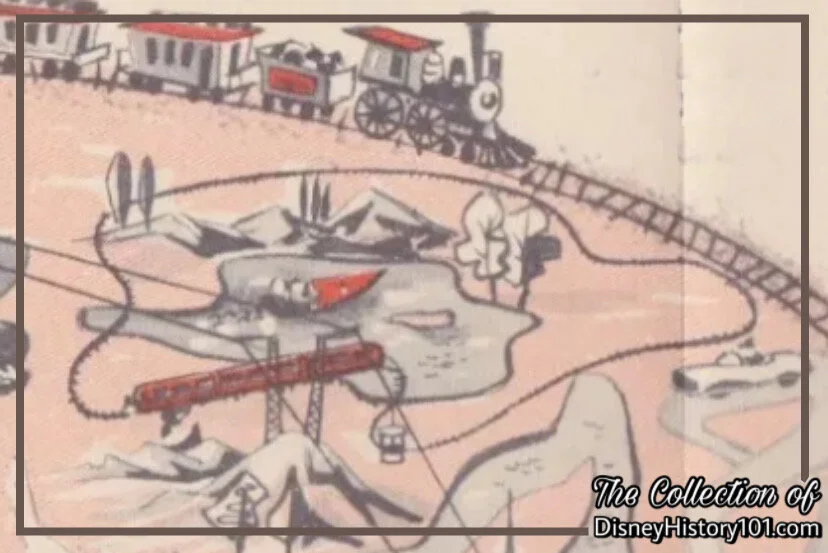
During the Viewliner’s operation, the Fred Gurley became the seventh train in the Park. There were four types of trains - and a total of seven additional trains are in use at Disneyland. Two Western mining trains carry visitors over Rainbow Desert and through the colorful Rainbow Caverns in Frontierland. In Tomorrowland and Fantasyland, two sleek, futuristic Viewliners speed passengers between the two lands. And in Fantasyland, the unique Casey Jr. trains huff and puff up hill and down adjacent to Storybook Land.
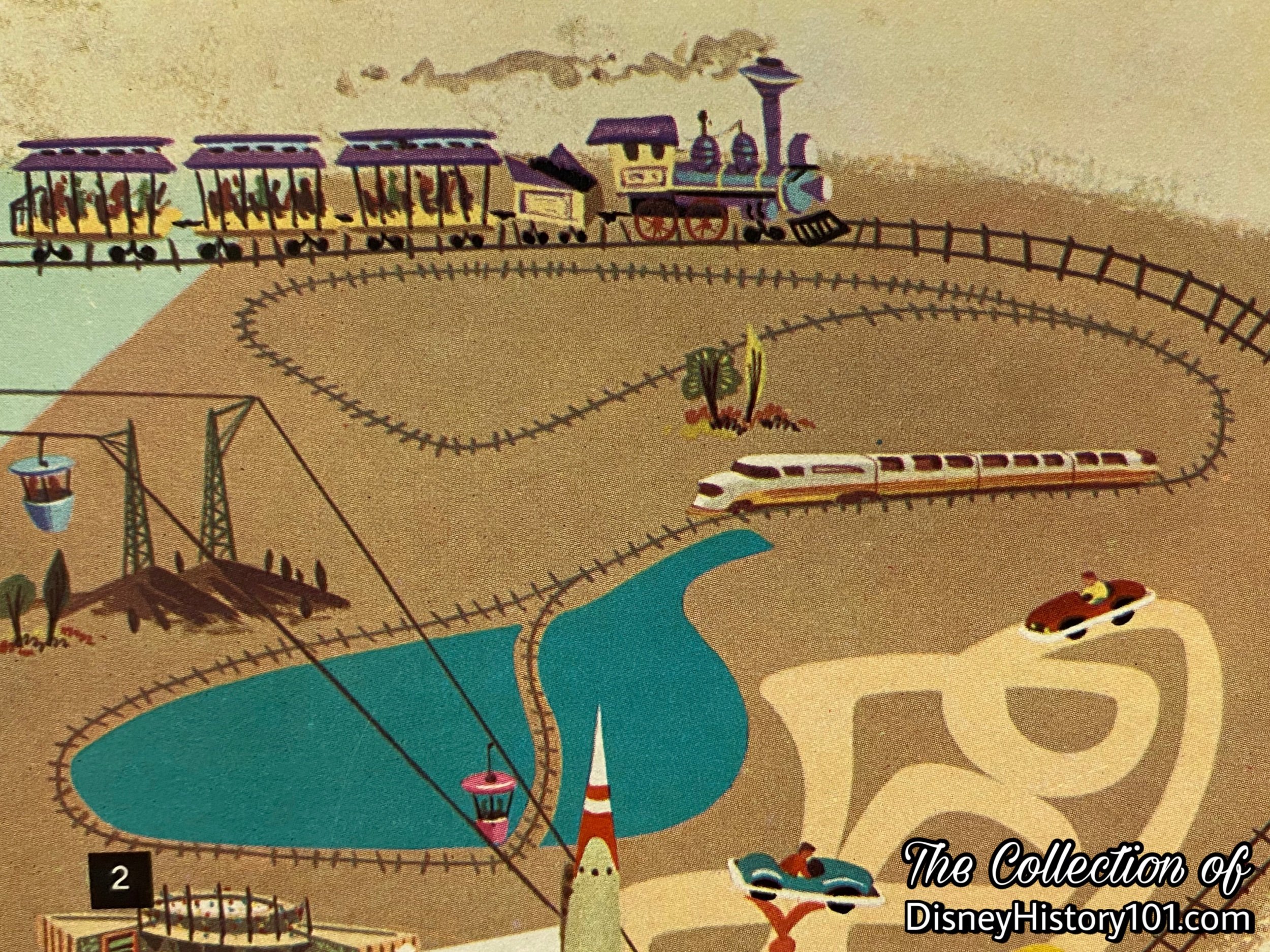
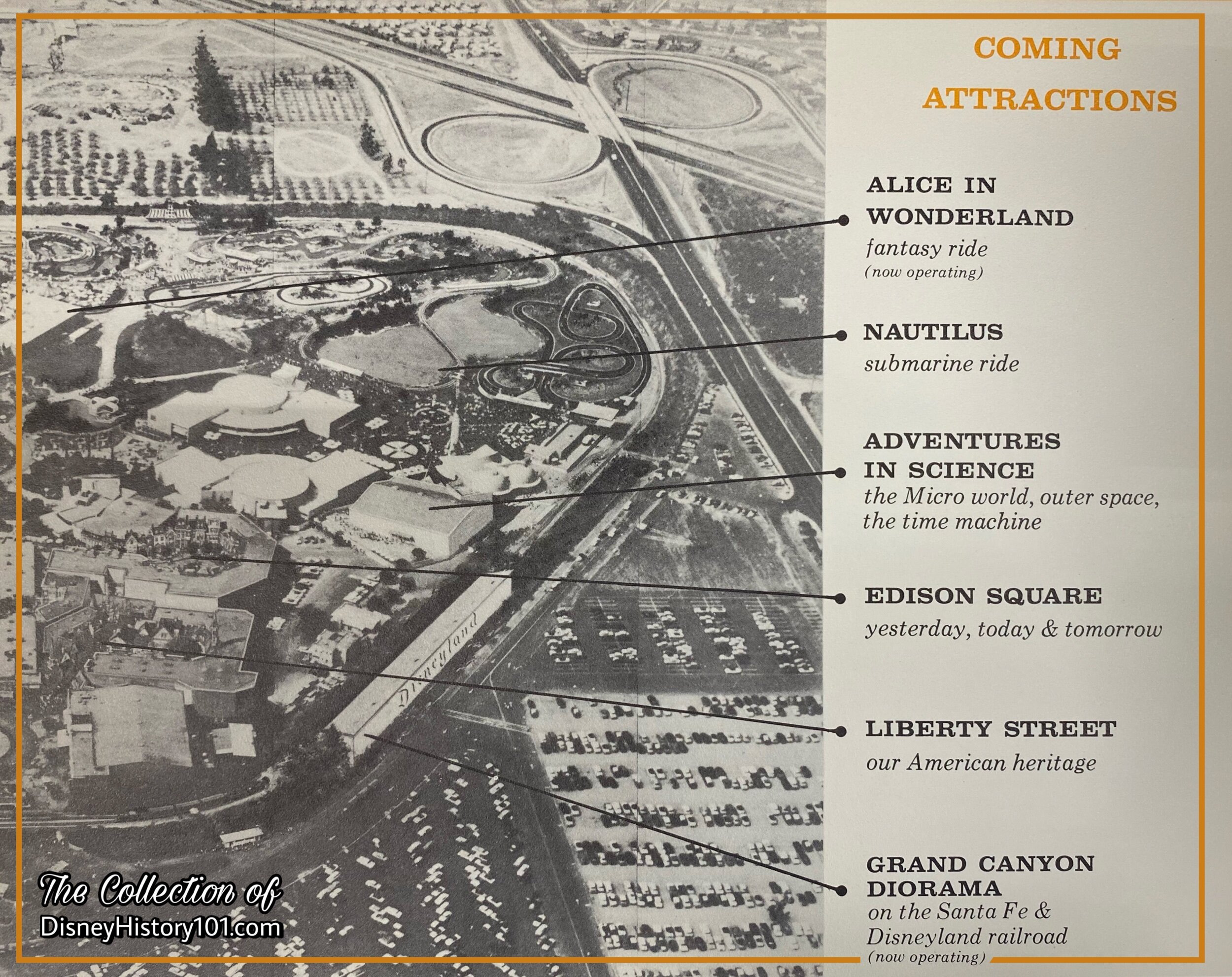
While the Viewliners were still in operation, this promotional “Disneyland U.S.A.” booklet distributed to potential National sponsors (or, “Participants”) in Disneyland. This map of “Coming Attractions” labels a coming “Nautilus submarine ride” to be installed in the area of the Tomorrowland Lake. By the time this publication was distributed, the final touches were likely being added to the ALWEG-Disneyland Monorail Trains - successor of the Viewliner Train of Tomorrow.
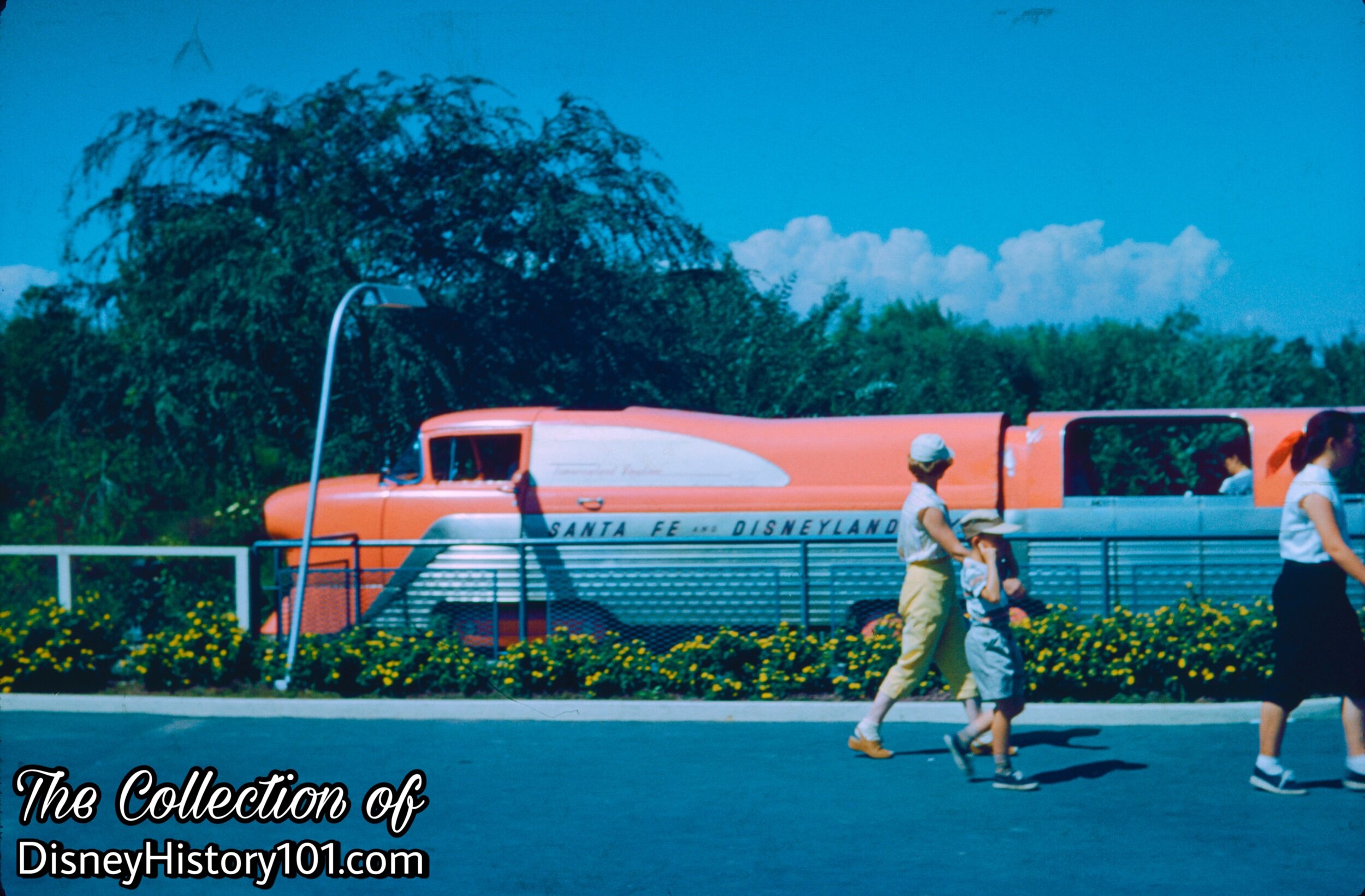
The Viewliner Train of Tomorrow was one of the fastest of Walt’s Disneyland trains, and sadly one of the shortest-lived Disneyland attractions! Here, we catch a glimpse of the Tomorrowland Viewliner Train of Tomorrow, during one of its final runs in August of 1958. When the Viewliner Trains of Tomorrow had ceased operation (on September 30, 1958) after 15 months of operation, a grand total of 1,452,870* guests had stepped “all aboard” for a grand figure eight tour (According to one Disneyland Attractions & Media Reports, prepared for 1971)!
*As a sidelight, Walt Disney’s Railroad Story (by Michael Broggie) gives a slightly different figure, stating : “During its operational life, the Viewliner attraction carried 1,430,683 ‘B’-ticketed passengers.”
By September 28, 1958, an appraisal of Disneyland “land improvement” assets valued the Viewliner Turnstile at $523. That same day, WED Enterprises, Inc. began to remove the Viewliner tracks and ties (job #4010-516) at a cost of $2,376 and remove Viewliner electrical equipment (job #4010-517) at a cost of $805. The entire removal cost $3,181.
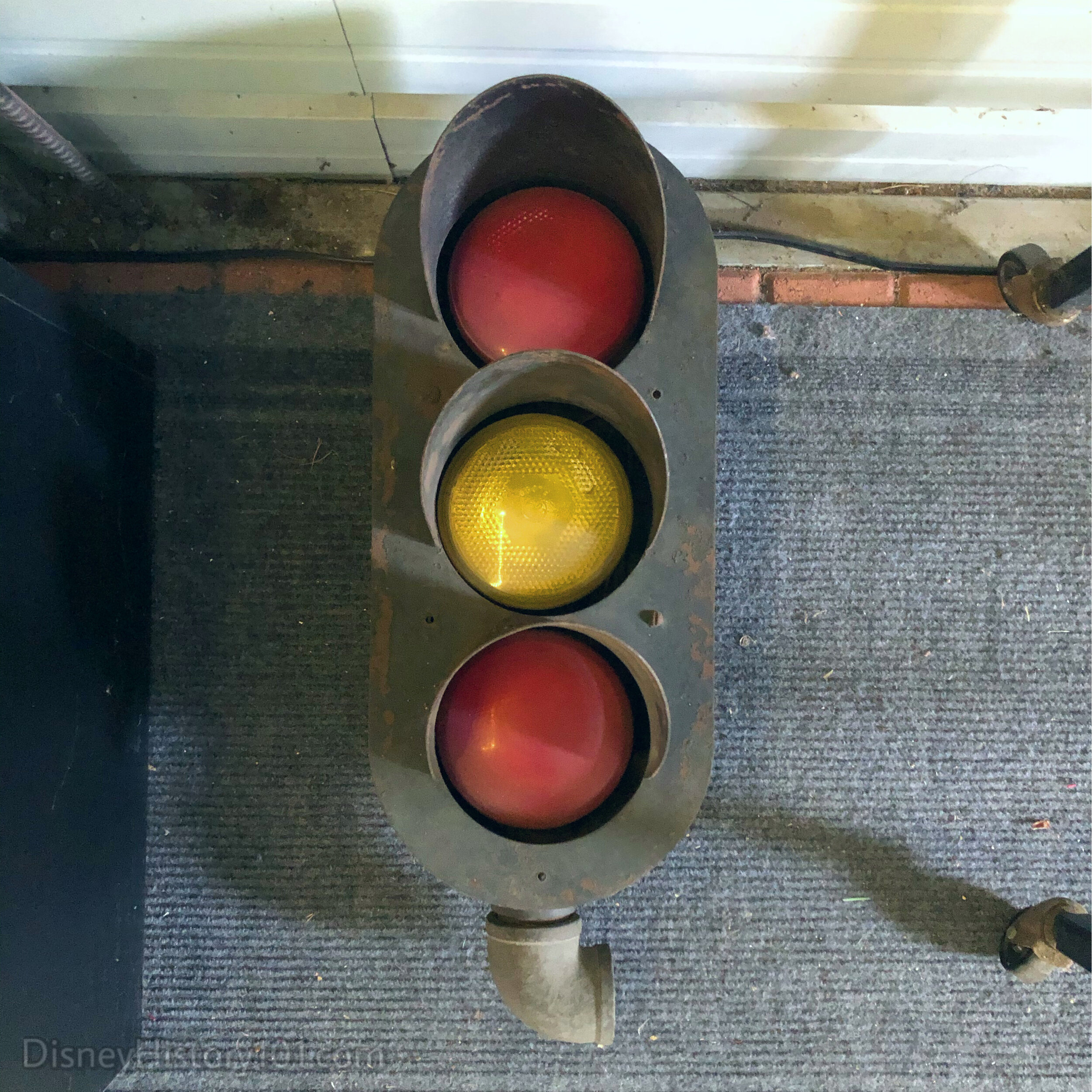
Aside from the occasional railroad spike, there are few extant remnants from this once popular (but short-lived) Disneyland attraction. This particular signal lamp was used near one of the Viewliner stations. There were also smaller ‘running lights’ utilized near the Viewliner junction points. The Viewliner’s railroad block signal system kept guests and engineers safe for the duration of their journey.
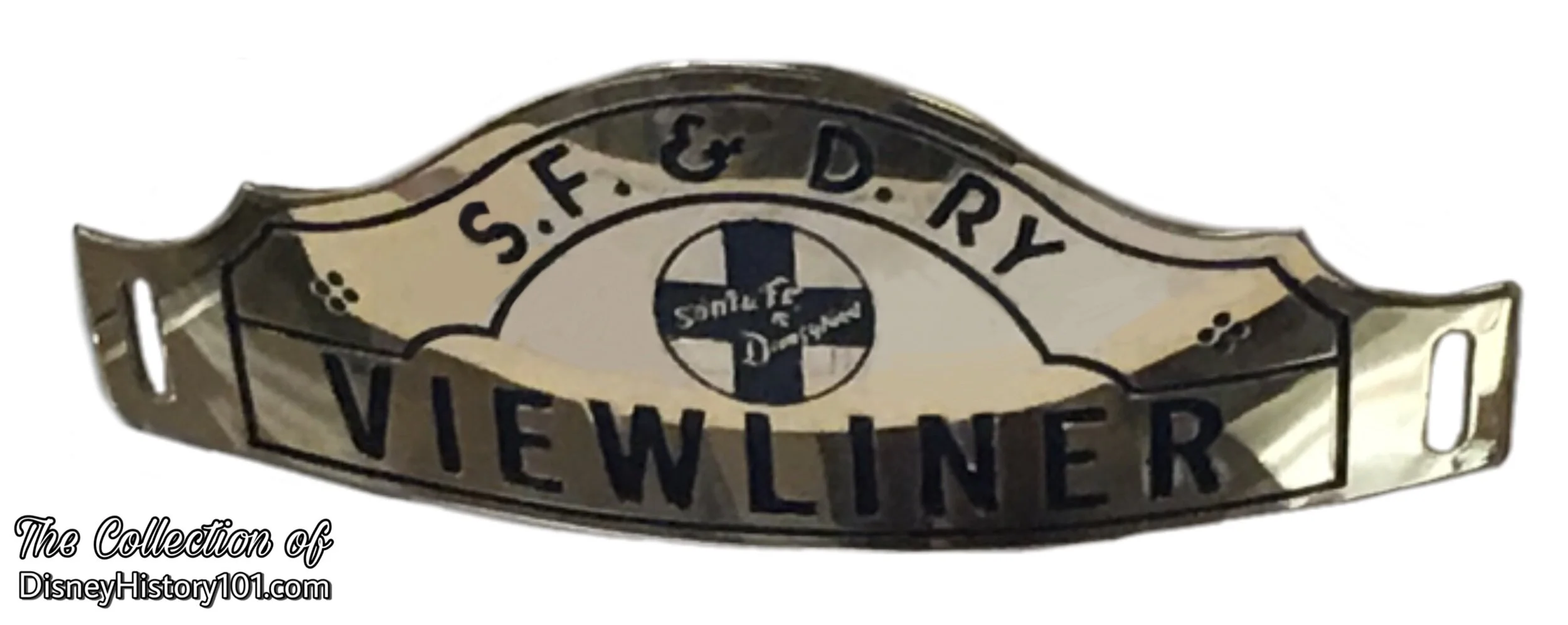
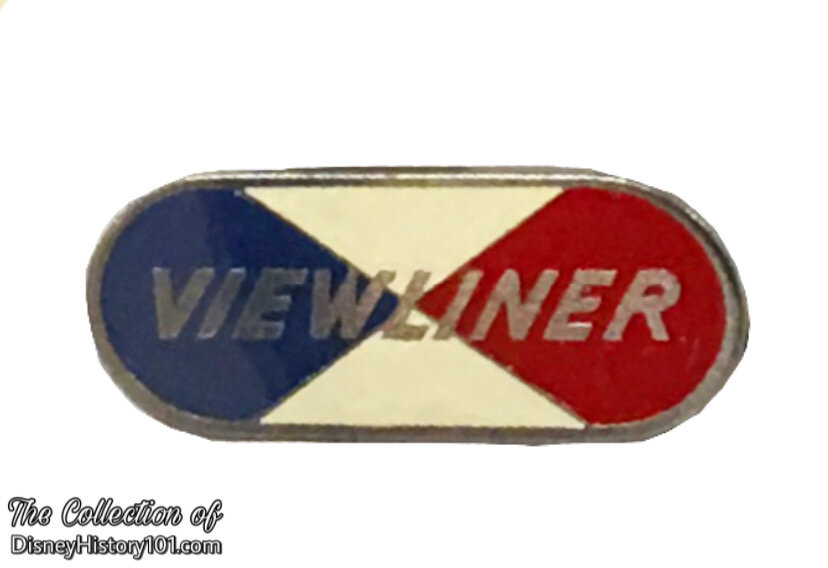
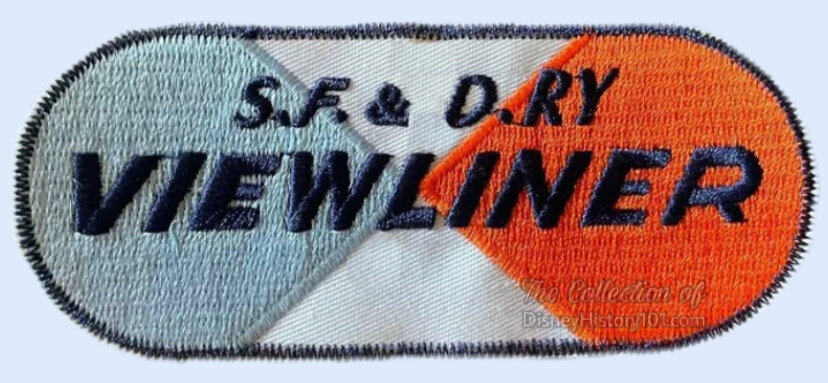
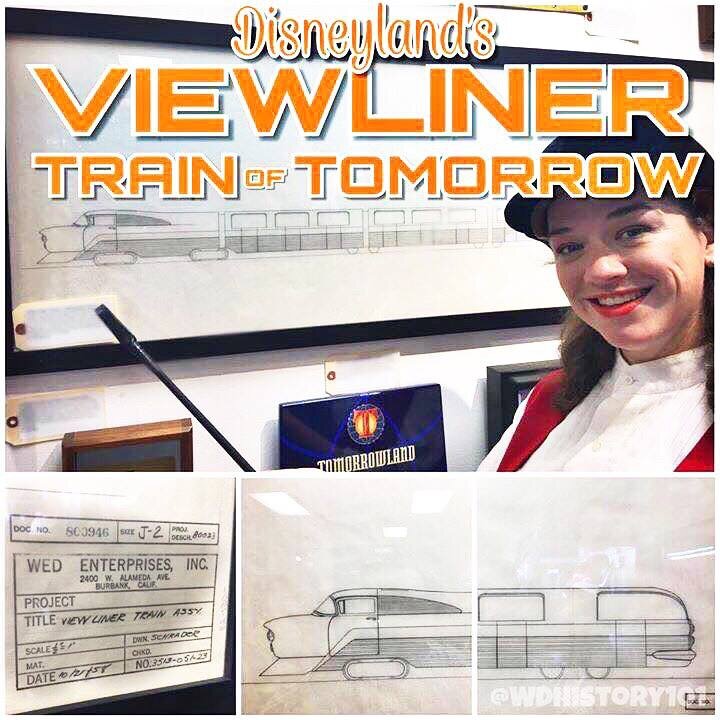
Sadly, no remnants from either train are known to exist. However, this 16.5” x 61” drawing was created after the Viewliner was closed, but it gives us an idea of the proportions of various parts of the engine and cars in relation to each other (at least from a profile). It was believed (by the previous owner), that these drawings were created for the removal of the attraction from the Park.
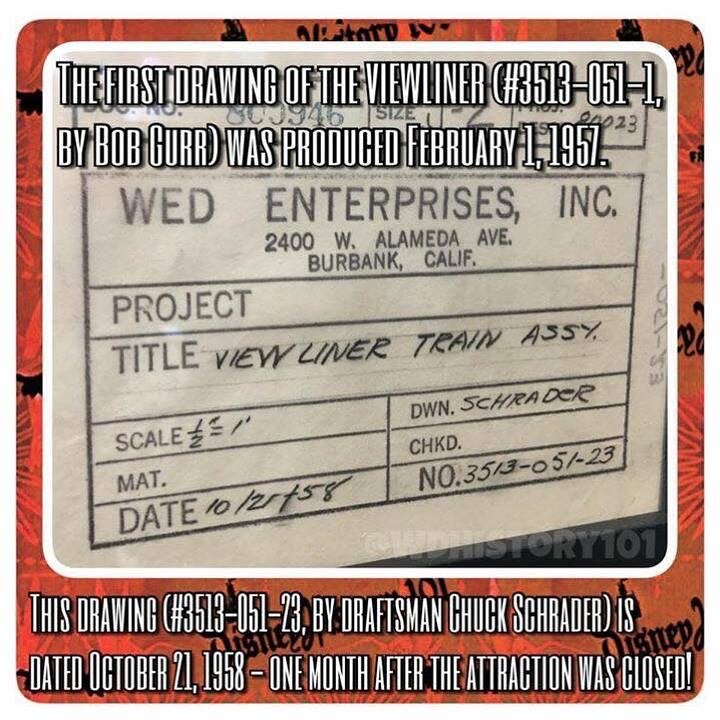
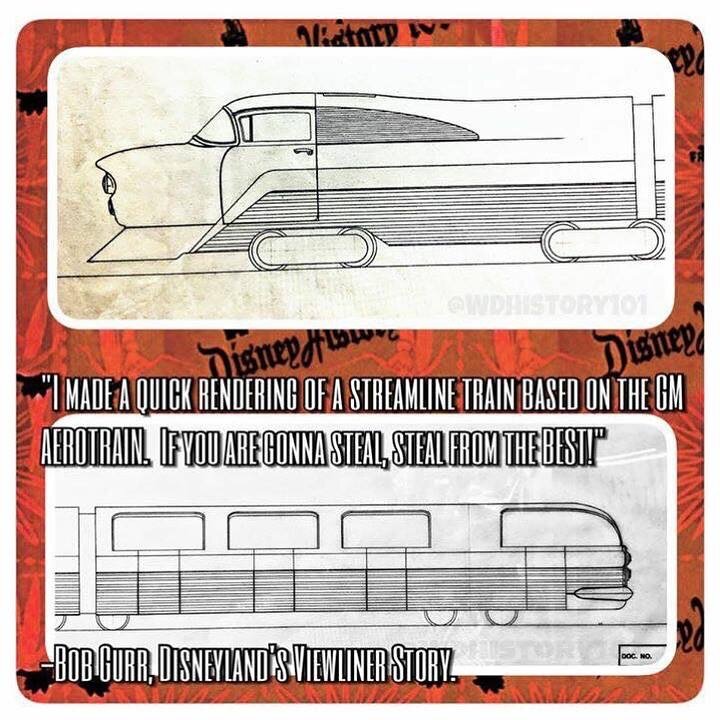
WIZARD of BRAS (Hollywood- Maxwell Intimate Apparel Shop)

“The Walt Disney Company & Intimate Apparel Products”
Some may find it odd that Disneyland once hosted an intimate apparel shop. But in fact, the history of the Walt Disney Company and women’s foundation garments actually dates back to the 1930s.
MILER CORSETS, Inc, included ten Snow White models in their “Smarties” line, Walt Disney's fairy tale princess being woven or printed on the fabric. Mickey and Minnie also appeared on many types of patterned clothing licensed and manufactured by companies like Miller Corsets, Inc. of Canandaigua, N. Y.
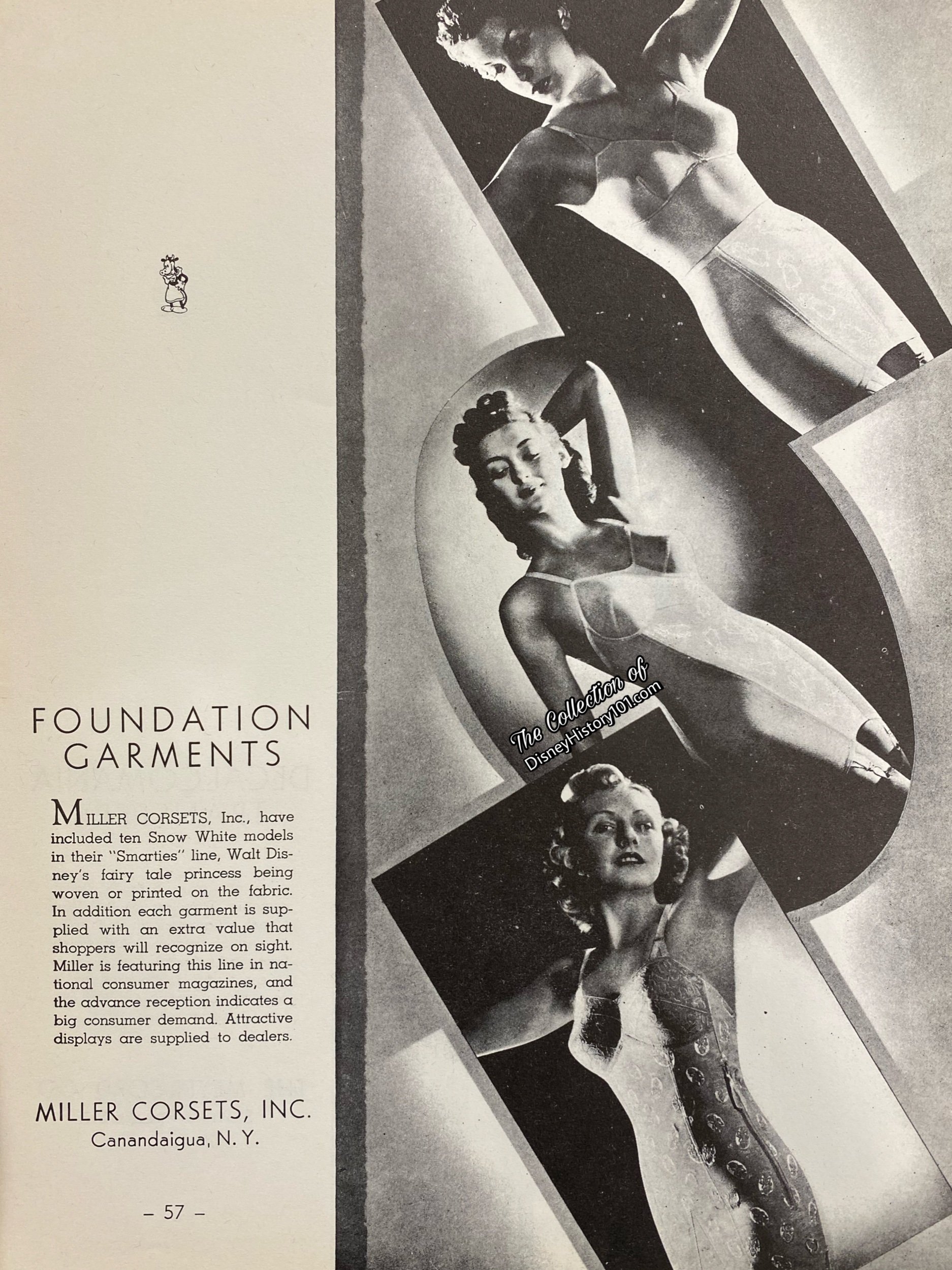
“Disneyland Participant Sponsorship”
Decades later (during 1954), Walt was searching for participants to lease shop and restaurant spaces at Disneyland, and help generate the necessary capital to fund construction of Disneyland. By July 1, 1954, George Whitney of Disneyland, Inc. directed Amusements, with Ron Miller overseeing analysis, philosophy, capacities, planning, operator training, and amusement procurement. By July 1, 1954, Russel Tippett of Disneyland Inc. Advertising oversaw Exhibitor’s Space Sales and Lease Agreements. In a synergistic relationship, the companies (in turn) could sell their products and advertise their corporate names in the Park. Disneyland Participant Corporate Sponsors were carefully selected. High quality, long term corporate sponsors would provide incremental income that enabled Disneyland to enhance its show and attractions, offset some operating expenses, and capitalize on marketing opportunities.
This would prove profitable four years later (in 1958), when Bank of America appraisers figured of the total income received from leases - 16.02% was derived from the selling of advertising rights and 40.12% from the leasing of space to concerns whose main reason for occupancy is for advertising purposes. The remaining 43.86% of the lease income was derived from stores that sell various products and food.
For now, Main Street was soon full of wonderful free exhibits hosted by a variety of “old firms” - time-tested American companies! These free exhibits celebrated turn-of-the-century American businesses that adorned small towns across the country’s landscape, while age lived “fond memories of the past.” As a result, “shopping has been a part of the Disneyland scene since opening day, 1955, when just 45 employees worked in the Park’s five stores and stands,”according to Disney News (Fall, 1966). The same publication called Walt Disney’s “Magic Kingdom actually… like a huge specialty shopping center, with thirty Disney-operated stores catering to every taste and purse. In addition, some of America’s most famous ‘name brand’ merchandise is sold in the stores of Park lessees.” It is notable to mention that during these early years, it was commonplace for merchandise locations to stock General Merchandise - non -character and/or decorative items, including film and sundries.
Several of those “old firms” specialized in name brand apparel for men, women and children! One shop (located North of Coca Cola Refreshment Corner) originally housed an exhibit dedicated to the evolution of swimwear, as well as modern swim wear merchandise by manufacturer and retailer Cole of California (from 1955 to 1957). Fantasy of Disneyland also carried clothing - like a large selection of designer little cardigan sweaters, party dresses, “Hollywood Knits,” and jumpers (by vendors like Johnny Lee of California, or Nob Hill of California). Gallen-Kamp (Famous for their “all leather shoes” sponsored Bluebird Shoes For Children, and Pendleton sold their woolen mills products - skirts, ties, and coats. Grandma’s Babies Shop operated by Don Frank Enterprises sold baby fashions. These were just a few of the clothing shops that were located inside Walt Disney’s MAGIC KINGDOM®, while there were many others that came to be located at the Disneyland Hotel!
Last (but not least important) the V-Ette Corset Shop (also billed as the Hollywood- Maxwell Intimate Apparel Shop), presented by the Hollywood-Maxwell Brassiere Co. of Los Angeles, afforded guests the opportunity to view “early day corsets and foundation garments,” from July of 1955 through January of 1956. The Hollywood-Maxwell Brassiere Co. was one such firm - and one of the largest brassiere manufacturers in the world. While their brassier factory was located in Paris, their central warehouse was located in Dallas and their main offices were located in Hollywood, California!
The lessee would soon occupy a 443 square-foot parcel in Building #500. As of June 2, 1955, C.V. Wood Jr. sent an Inter-Office Memorandum to Walt Disney regarding the best estimates that could be obtained at the time regarding the completion status of individual sections of the Park and Opening Day. C.V. wrote: “Building #506 - Hollywood-Maxwell: If they remain as a Lessee, it is very doubtful if they can be ready for opening.”
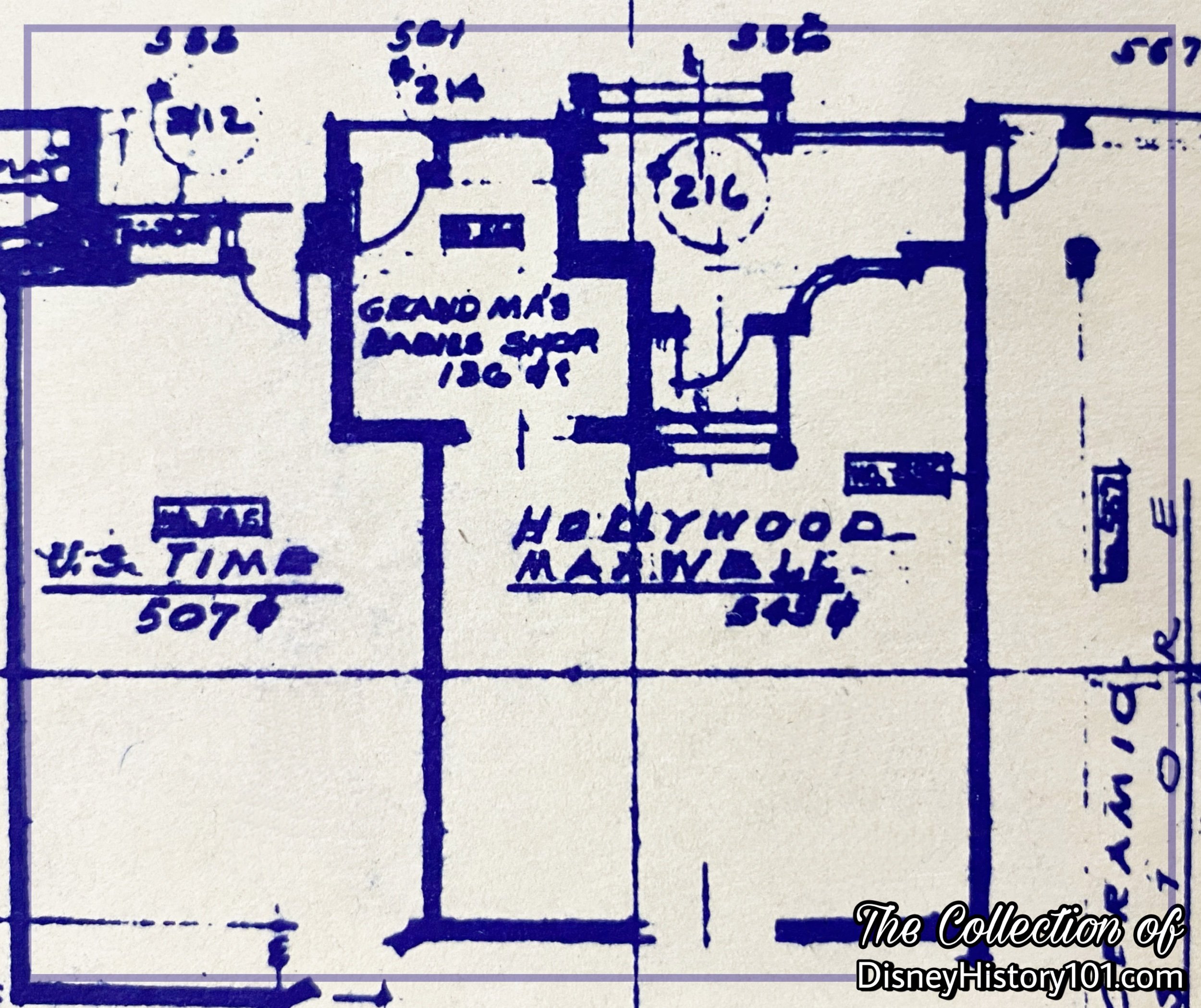
“Disneyland is unique in that some of the world's foremost creative artists and architects control all design at Disneyland.“
“Construction”
“When the giant earth-moving undertaking was completed, the building crews took over. Soon, the rat-tat-tat of riveters was shattering the air, and sparks were flying from welders’ torches as the steel frameworks, capable of withstanding the ravages of time and the elements rose above the newly formed ground. While carpenters hammered and masons laid row upon row of brick and stone and mortar, the permanent buildings began to take shape and form,” according to “The Disneyland Story” published 1955. One of the first buildings to be constructed was the Main Street Opera House, which was used as the Mill. Here, the woodwork of Disneyland was generated - from the functional to the aesthetic! Approximately three and one-half million board feet of lumber went into the Park’s construction. Much of the wood was processed here by McNeil Construction (which formerly constructed Walt Disney Studio sound stages in 1947 and 1953), and under the direction of George Mills Sr. (the Prime General Contractor and Mill Foreman). Then, under the direction of Joe Fowler (Construction Supervisor), as well as Charles Alexander and Ray Conway (Construction Field Supervisors), the lumber was soon fashioned into the framing belonging to the very first buildings constructed at Disneyland - primarily the Main Street Complexes (on each side of the street).
F.M. Franz, manager of operations for MeNeil Construction expressed: "We feel sure there has never been anything built like this in Southern California, or elsewhere in the United States. Many of the items were constructed from artist’s sketches.” In constructing each building, a concrete foundation and slab floors were prepared, followed by wood frame construction (while store units would have a combination wood and rigid steel frame). ”The first fabricated steel for the Main Street buildings arrived November 8 and was erected,” according to the narrator of “Disneyland - The Park,” a Disneyland anthology television series excerpt, first aired 1957 and Disneyland LINE (November 22, 1979).
According to inserts published in area newspapers during July of 1955, Disney buildings were roofed by Pioneer Roof & Shingle Company (then located at 608 Mateo Street, Los Angeles, California; 7522 Westminster Avenue, Westminster, California). The roof covering was a variable, dependent on the architectural design.
As of June 2, 1955, C.V. Wood Jr. sent an Inter-Office Memorandum to Walt Disney regarding the best estimates that could be obtained at the time regarding the completion status of individual sections of the Park and Opening Day. C.V. wrote: “Electric Signs: All are in work - with the exception of the shoe store and the Bank of America, all will be completed.” Newbery Electric Corporation gave electricity to Disneyland. “The electrical installations were supervised by Roy J. Gruendler, manager of Newbery's Orange County district office located at 1335 Santiago Ave, Santa Ana.”
The Main Street Building #500 (as each on Main Street U.S.A.) possessed complete fire sprinkling systems. By June 30, 1955, related Disneyland Site Work Fire Protection Utilities Plot Plans were prepared for Disneyland Inc., by J.E. Thomasson of WED Enterprises Inc.
All fixtures were placed in their correct motif and many light fixtures of Disneyland were authentic antiques.
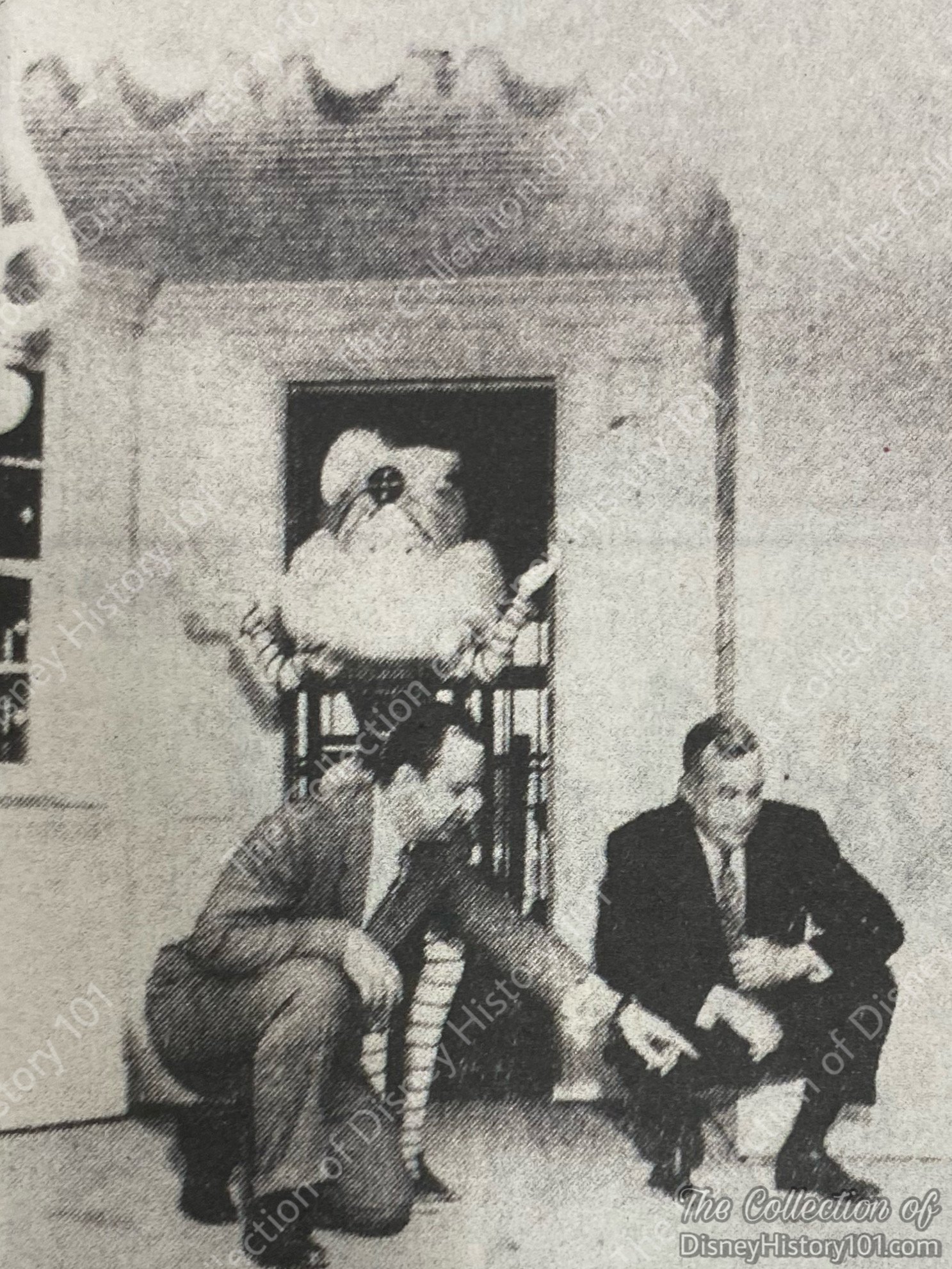
“The Hollywood-Maxwell Brassiere Co. Exhibit”
Disneyland guests were familiar with Hollywood-Maxwell Brassiere Co. products, as their brassieres were shipped to every United State through several retail outlets. However, as Walt described to Bob Thomas (of Associated Press), “some industries will have exhibits, but all of them must be in keeping with the era.” Here in the Park, guests could view“early day corsets and foundation garments,” according to “Welcome to Disneyland” (published 1956). Guests could also purchase both brassieres and torsolettes. There were c. 1955 Nu-Vu bras (“for fuller figures”), c. 1955 Mais Oui Convertible, the c. 1957 B. Altman & Co. floral V-Ette brassieres, c. 1953 Holly-Ette Whirlpool brassieres (which were still popular, as they accommodated women who needed “in-between” sizes), “3/4 Time Torso” Whirlpool brassieres, and strapless Whirlpool brassieres.
Hollywood-Maxwell Brassiere Co. created tangible memories for our Guests through Merchandise and Show. Now, “Disneyland is a place to have fun… and with the fun it is a place where you can learn,” according to “Disneyland, U.S.A.” (published 1958, for potential Participants). Much like the aforementioned free exhibits, there were numerous artifacts on display. An authentic 1860 Singer Sewing Machine was a “most unusual and unique part of the display” (according to one publication).
Still, perhaps the most unusual part of the display (in our opinion), was the “illusioneered,” “mechanical wizard… [emceeing a] continual show of fashions”! If you are wondering what this animated emcee looked like, contemporaneous advertisements (printed in publications) preserve the mysterious and wonderful “Wizard of Bras” for the curious. Above, “C. V. Wood (left), vice president and general manager of Disneyland, and Herndon J. Norris, president of the Hollywood-Maxwell Brassiere Co., plan final details of display which will occupy a Victorian ‘Shoppe’ on Disneyland's Main Street, U, S. A. Theme of the exhibit will be the "Wonderful Wizard of Bras" whose tape-recorded "voice" will emcee the continual showing of intimate apparel and outer wear styles from the 19th Century to 1955.”
One of the most in-depth published sources about this new exhibit attraction is the article “Mechanical Wizard Emcees Continual Show of Fashions,” published July 15, 1955, as a supplement for the “Register” of Santa Ana, California.
Air-conditioning controlled dust, and a practical mechanical application of the technology was essential in the attraction where projection equipment and film was used.
Before Disneyland opened, an article published in Pacific Coast Review (published July 15, 1955), briefly and ambiguously mentioned that “Other names in this advertisers wonderland include Hollywood-Maxwell corset and bra line.”
According to The Disneyland Shopper (published 1955): “Half the fun of buying Christmas Gifts is the atmosphere you shop in. You couldn't ask for more in the way of the spirit of Christmas than to shop in Disneyland. Especially along Main Street will you catch the air of the good old-fashioned Christmas with wreaths of holly, Christmas bells, carolers, snow-frosted windows gaily decorated with fairytale rhymes, and the scent of pine boughs in the air. Ringing through this Magic Kingdom are the Christmas Songs we all love to hear.”
Considering all of these displays, it is easy to see why by the year 1958, the Hollywood- Maxwell Intimate Apparel Shop was considered one of 15 free educational shows and exhibits at Disneyland.
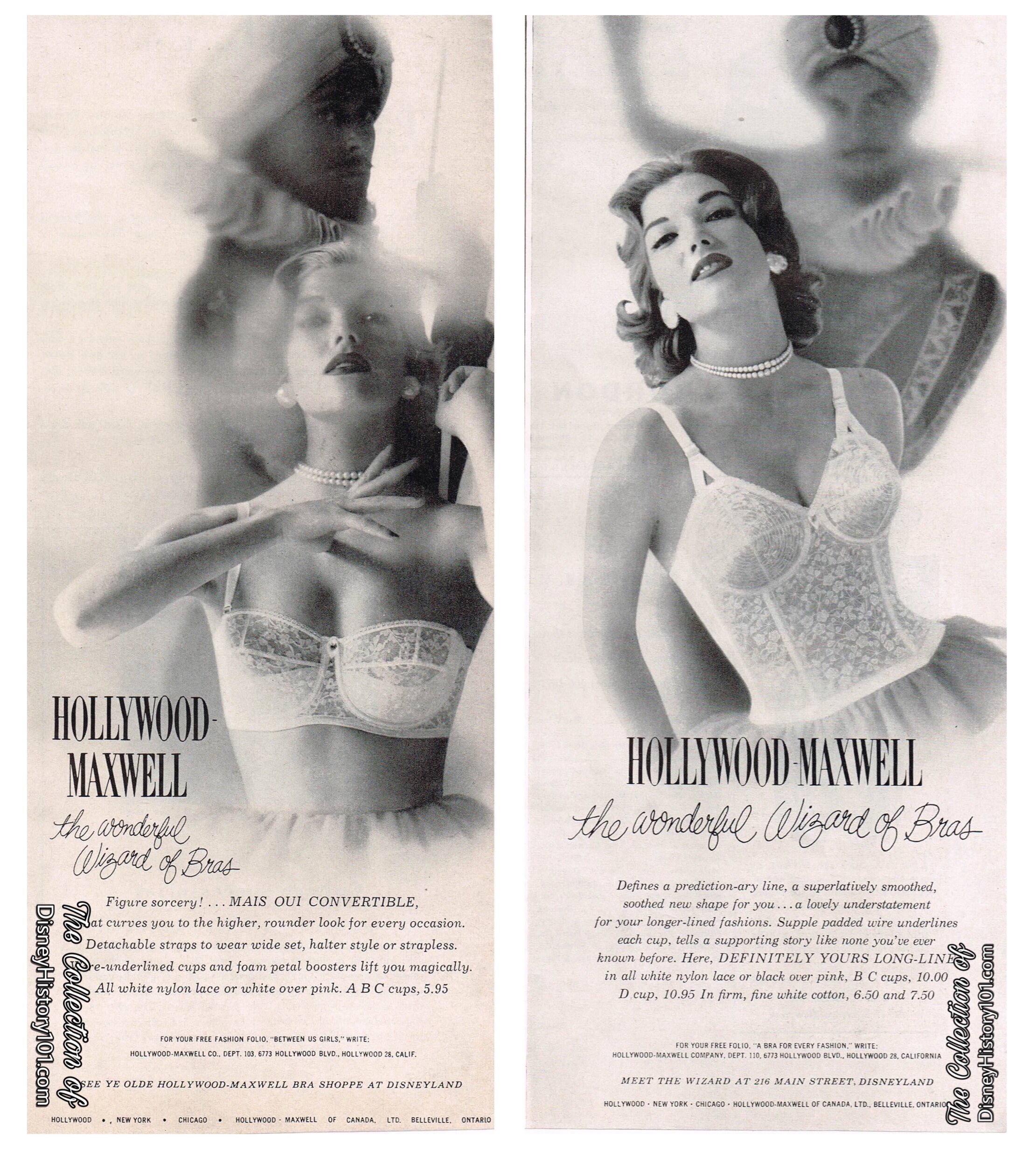
Now, “Disneyland is a place to have fun… and with the fun it is a place where you can learn,” according to “Disneyland, U.S.A.” (published 1958, for potential Participants). Much like the aforementioned free exhibits, there were numerous artifacts on display. An authentic 1860 Singer Sewing Machine was a “most unusual and unique part of the display” (according to one publication). Still, perhaps the most unusual part of the display (in our opinion), was the “mechanical wizard… [emceeing a] continual show of fashions”! If you are wondering what this emcee looked like, contemporaneous advertisements (printed in publications) preserve the mysterious and wonderful “Wizard of Bras” for the curious. One of the most in-depth published sources about this new exhibit is the article “Mechanical Wizard Emcees Continual Show of Fashions,” published July 15, 1955, as a supplement for the “Register” of Santa Ana, California. If you would like to hear roughly a minute of the narration from the Intimate Apparel Show, please visit the following link HERE.
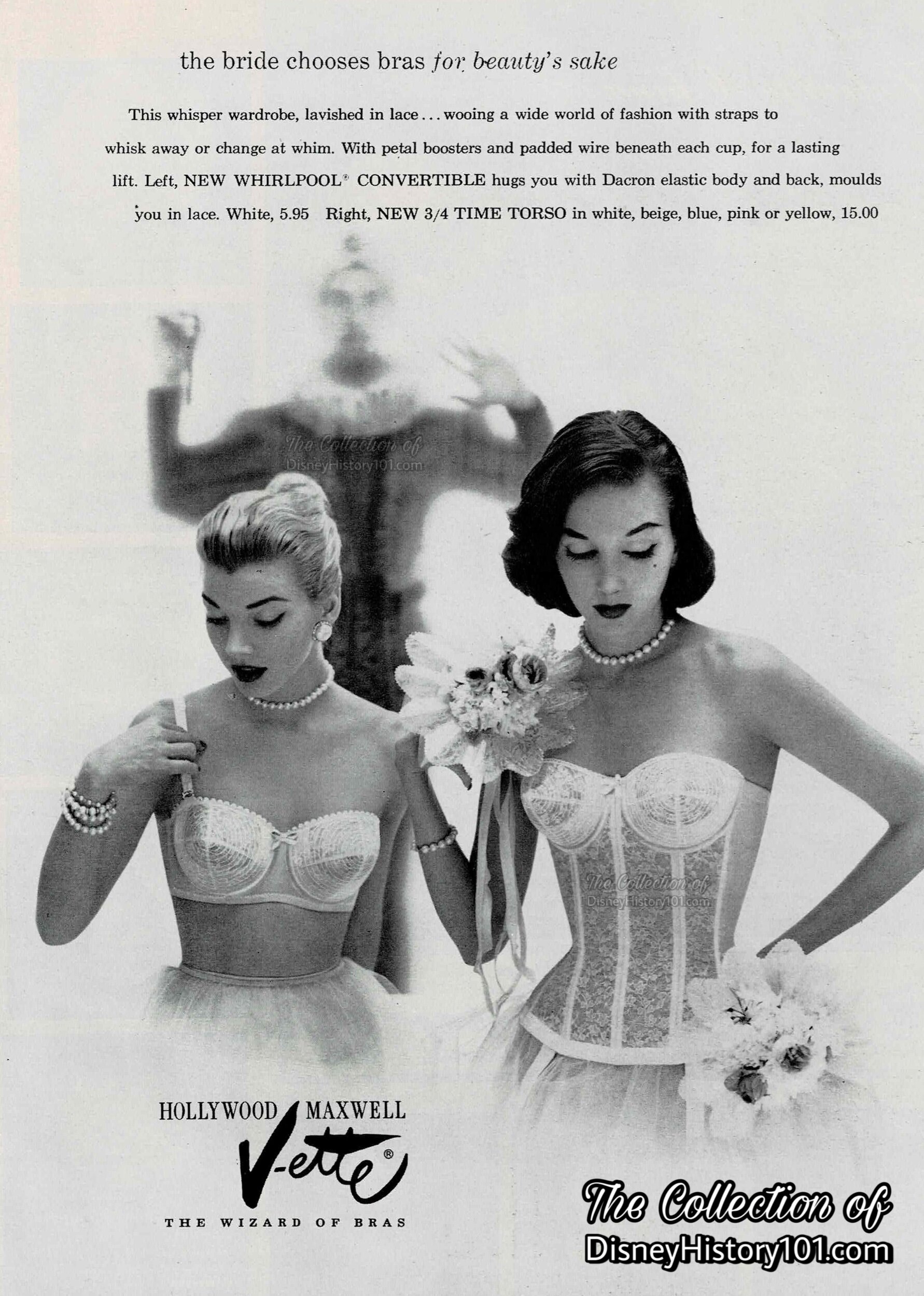
By the release of the “Disneyland 1st Anniversary Souvenir Pictorial” in 1956, the shops of Main Street U.S.A. were reckoned among the ”stores whose shelves bulge with worlds of distinctive merchandise.” Alas, the Hollywood- Maxwell Intimate Apparel Shop was short-lived, operating for less than a year (and was not around by the time of this special publication). The 443 square-foot Hollywood Maxwell parcel (or, store space) was absorbed by Ruggles China & Gift.
However, this intimate chapter of Hollywood-Maxwell & Main Street, U.S.A. history represents such a quaint and charming time of sponsorship and shopping at Disneyland - one that we shall not forget!
By January 1, 1958, Ruggles China & Gifts had grown beyond their original 1,024 square-foot shop and consumed two other parcels (a 308 square-foot hallway addition and the 443 square-foot former Hollywood Maxwell shop). In the present, the building serves as the Palm Parlor, where Disney Legend Rolly Crump serves as an assistant (owing to a window Imagineered by Jeremy Fulton).
WURLITZER MUSIC HALL
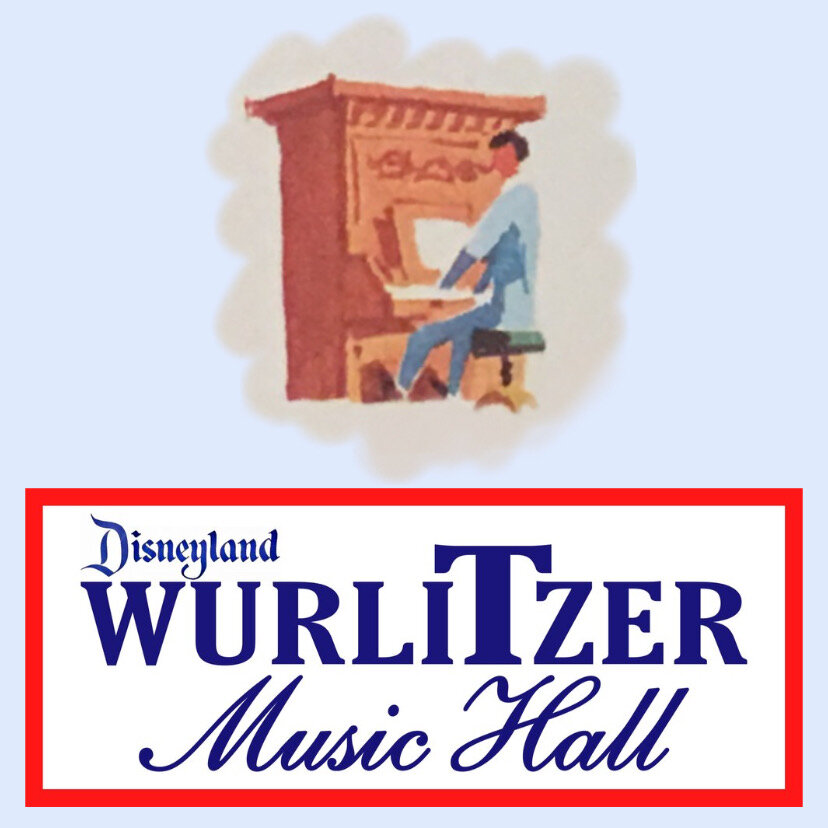
During 1954, Walt was searching for participants to lease shop and restaurant spaces at Disneyland, and help generate the necessary capital to fund construction of Disneyland. In a synergistic relationship, the companies (in turn) could sell their products and advertise their corporate names in the Park. By July 1, 1954, George Whitney of Disneyland, Inc. directed Amusements, with Ron Miller overseeing analysis, philosophy, capacities, planning, operator training, and amusement procurement. By July 1, 1954, Russel Tippett of Disneyland Inc. Advertising oversaw Exhibitor’s Space Sales and Lease Agreements. Disneyland Participant Corporate Sponsors were carefully selected. High quality, long term corporate sponsors would provide incremental income that enabled Disneyland to enhance its show and attractions, offset some operating expenses, and capitalize on marketing opportunities.
Many of these were turn-of-the-center business pioneers. Years later in 1958, Bank of America appraisers figured of the total income received from leases, 16.02% was derived from the selling of advertising rights and 40.12% from the leasing of space to concerns whose main reason for occupancy is for advertising purposes. The remaining 43.86% of the lease income was derived from stores that sell various products and food. Clearly, these lessees would provide the needed income.

“Participant Sponsorship”
Soon, the Rudolph Wurlitzer Company - “the name that means music to millions” became “the name that means music in Disneyland”, when it became a free exhibit on Main Street U.S.A. during Disneyland’s first decade and beyond! As a result, “shopping has been a part of the Disneyland scene since opening day, 1955, when just 45 employees worked in the Park’s five stores and stands,” according to Disney News (Fall, 1966). The same publication called Walt Disney’s “Magic Kingdom actually… like a huge specialty shopping center, with thirty Disney-operated stores catering to every taste and purse. In addition, some of America’s most famous ‘name brand’ merchandise is sold in the stores of Park lessees.”
“Design”
“Disneyland is unique in that some of the world's foremost creative artists and architects control all design at Disneyland.
“Architectural Designs by Lessees”
Disneyland, Inc. printed materials for Lessees detailing specifications for architectural designs of exhibit spaces. These were revised by March 16, 1955 and issued to Lessees.
All of the interior architectural drawings were done by competent registered architects or an approved display house of the lessee's choice. All of the designs submitted by the lessee's architect, whether for buildings or construction of interiors in DISNEYLAND, were approved as to the theme and general plan of DISNEYLAND as established by WED Enterprises, Inc.
Three sets of preliminary drawings were furnished DISNEYLAND, Inc. as soon as possible after signing of the lease. Two sets were retained by DISNEYLAND and one set was returned to the lessee’s architect with any revisions noted thereon and stamped “APPROVAL TO PROCEED TO FINAL DESIGN.” This stamp when properly signed and dated constituted the lessee’s authority to proceed with the final drawings.
The Lessees revised their final drawings to incorporate any revisions noted on the approved preliminary drawings, and submitted three sets of the revised drawings to DISNEYLAND. One set was returned to the lessee’s architect and any revisions noted thereon are to be incorporated on the original drawings. When the lessee had incorporated the final revisions on the drawings, two sets of transparent ozalids were forwarded to DISNEYLAND for approval. DISNEYLAND would stamp both sets “FINAL DESIGN APPROVED” and “LESSEE’S CONTRACT DRAWINGS”, and return one set to the lessee who could then release drawings for bid and/or construction.

“Construction”
“When the giant earth-moving undertaking was completed, the building crews took over. Soon, the rat-tat-tat of riveters was shattering the air, and sparks were flying from welders’ torches as the steel frameworks, capable of withstanding the ravages of time and the elements rose above the newly formed ground. While carpenters hammered and masons laid row upon row of brick and stone and mortar, the permanent buildings began to take shape and form,” according to “The Disneyland Story” published 1955. One of the first buildings to be constructed was the Main Street Opera House, which was used as the Mill. Here, the woodwork of Disneyland was generated - from the functional to the aesthetic! Approximately three and one-half million board feet of lumber went into the Park’s construction. Much of the wood was processed here by McNeil Construction (which formerly constructed Walt Disney Studio sound stages in 1947 and 1953), and under the direction of George Mills Sr. (the Prime General Contractor and Mill Foreman). Then, under the direction of Joe Fowler (Construction Supervisor), as well as Charles Alexander and Ray Conway (Construction Field Supervisors), the lumber was soon fashioned into the framing belonging to the very first buildings constructed at Disneyland - primarily the Main Street Complexes (on each side of the street).
F.M. Franz, manager of operations for MeNeil Construction expressed: "We feel sure there has never been anything built like this in Southern California, or elsewhere in the United States. Many of the items were constructed from artist’s sketches.” In constructing each building, a concrete foundation and slab floors were prepared, followed by wood frame construction (while store units would have a combination wood and rigid steel frame). ”The first fabricated steel for the Main Street buildings arrived November 8 and was erected,” according to the narrator of “Disneyland - The Park,” a Disneyland anthology television series excerpt, first aired 1957 and Disneyland LINE (November 22, 1979).
Newbery Electric Corporation gave electricity to Disneyland. “The electrical installations were supervised by Roy J. Gruendler, manager of Newbery's Orange County district office located at 1335 Santiago Ave, Santa Ana.”
According to inserts published in area newspapers during July of 1955, Disney buildings were roofed by Pioneer Roof & Shingle Company (then located at 608 Mateo Street, Los Angeles, California; 7522 Westminster Avenue, Westminster, California). The roof covering was a variable, dependent on the architectural design.
As of June 2, 1955, C.V. Wood Jr. sent an Inter-Office Memorandum to Walt Disney regarding the best estimates that could be obtained at the time regarding the completion status of individual sections of the Park and Opening Day. C.V. wrote: “Building #611 - Wurlitzer: Estimated to be completed by the first of July. Electric Signs: All are in work - with the exception of the shoe store and the Bank of America, all will be completed.“
The building (as each on Main Street U.S.A.) possessed complete fire sprinkling systems. By June 30, 1955, related Disneyland Site Work Fire Protection Utilities Plot Plans were prepared for Disneyland Inc., by J.E. Thomasson of WED Enterprises Inc.
All fixtures were placed in their correct motif and many light fixtures of Disneyland were authentic antiques.
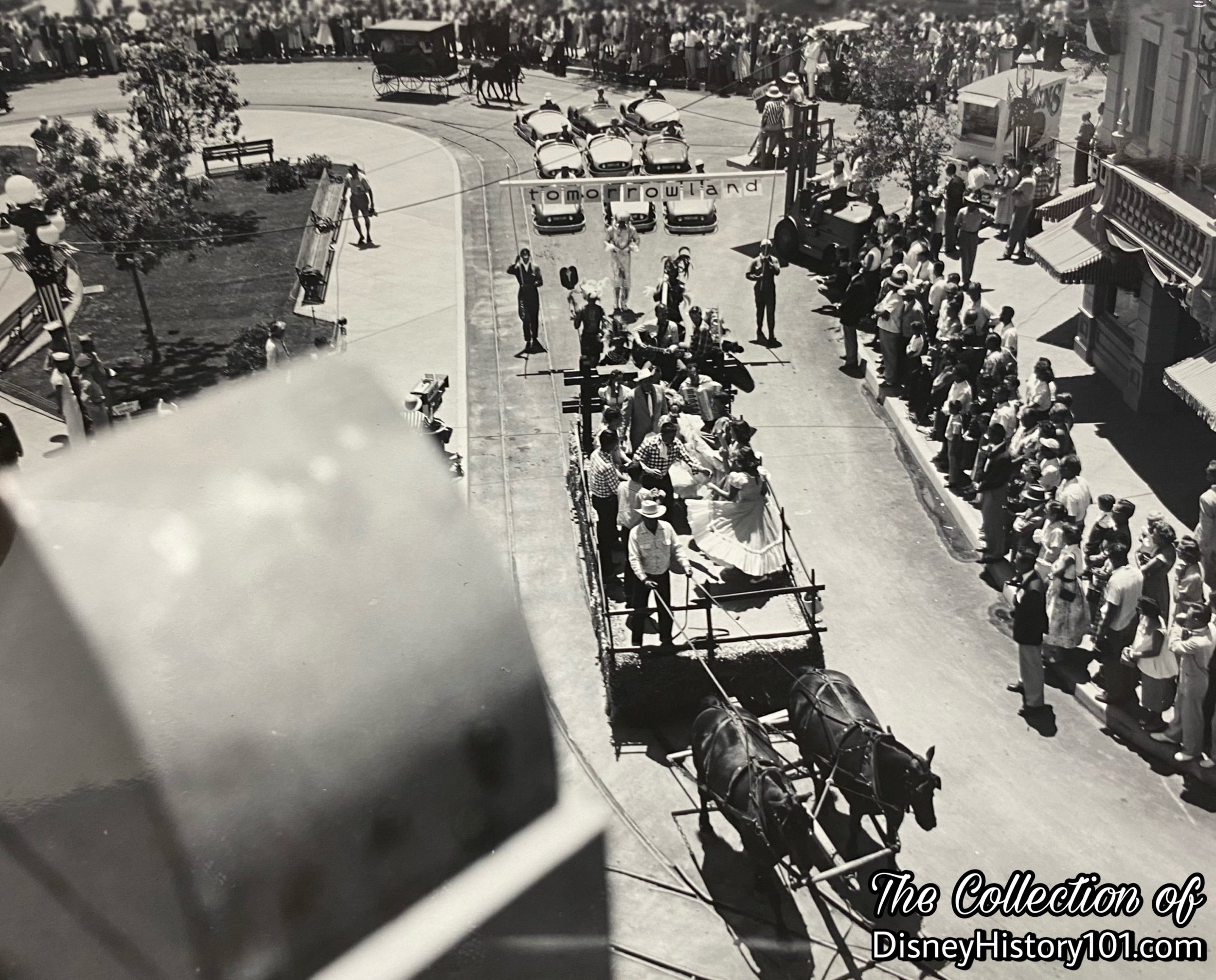
“Press Preview Day”
A contributing writer of The Daily Oklahoman (who visited on July 17, 1955) noted: “The guests walked into a city square of the 1900 era, bounded by an old time railroad station, city hall and fire station, opera house and other vintage merchant houses.” One such merchant house was the Wurlitzer Music Hall, which opened at 100 Main Street (on the East side of Main Street’s Town Square), on Disneyland’s opening day, July 17th, 1955. Above, Trooper Lights and Camera men were perched from the roof of Wurlitzer, as during the opening day parade in 1955.

“Dedication”
Walt described to Bob Thomas (of Associated Press), “some industries will have exhibits, but all of them must be in keeping with the era.”Wurlitzer was sponsored by one of the United States’ “old reliable firms, which have been in business fifty years or more. Here they can show how they started and reproduce their first place of business.” [Disneyland Prospectus, 1954]
The Wurlitzer free exhibit and shop was situated on two parcels measuring (915 square feet; 194 square feet) a total of 1,109 square feet. These two parcels were located between the Maxwell House Coffee Shop and the Wonderland Music Store for more than a decade, until September of 1968.
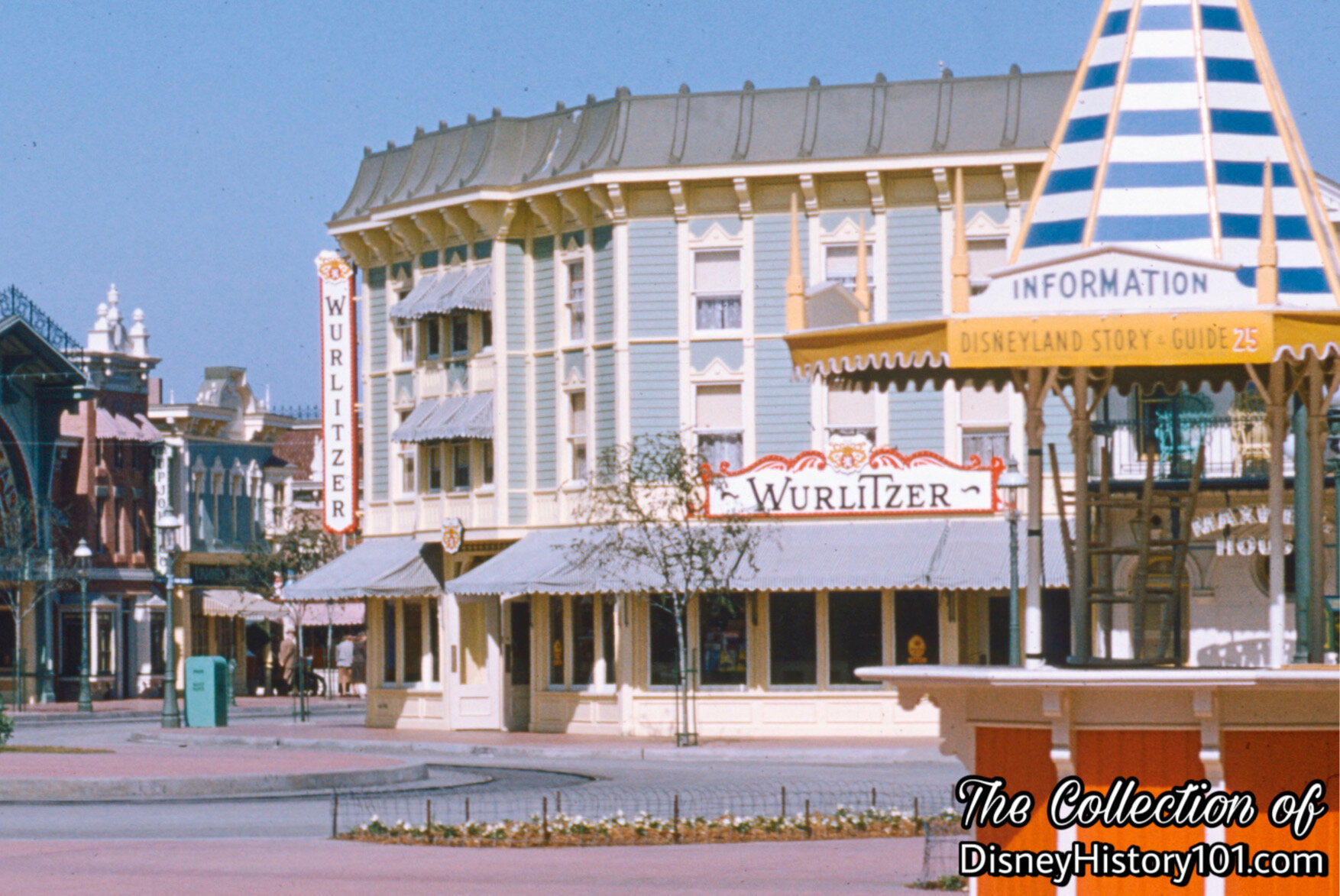
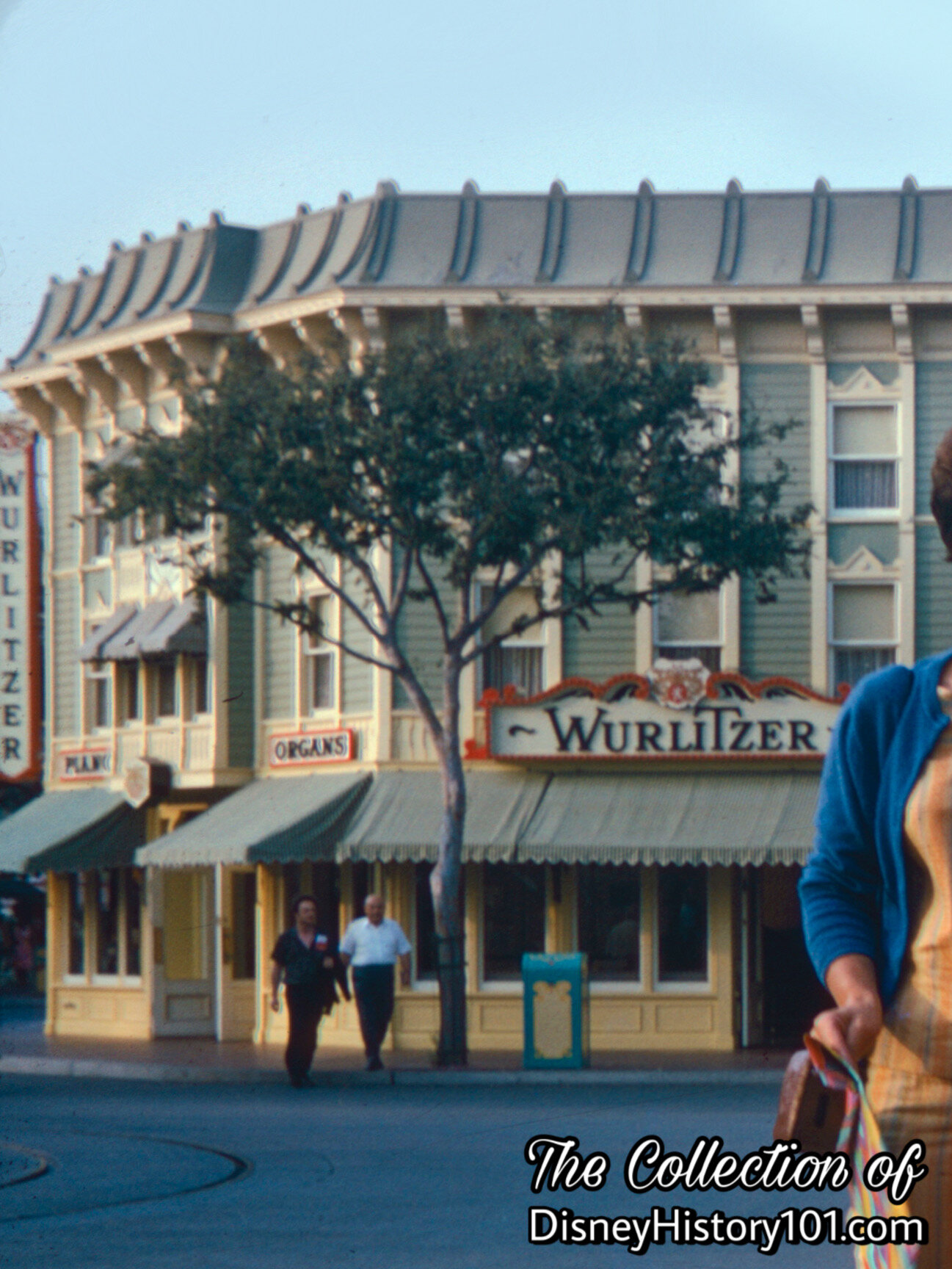
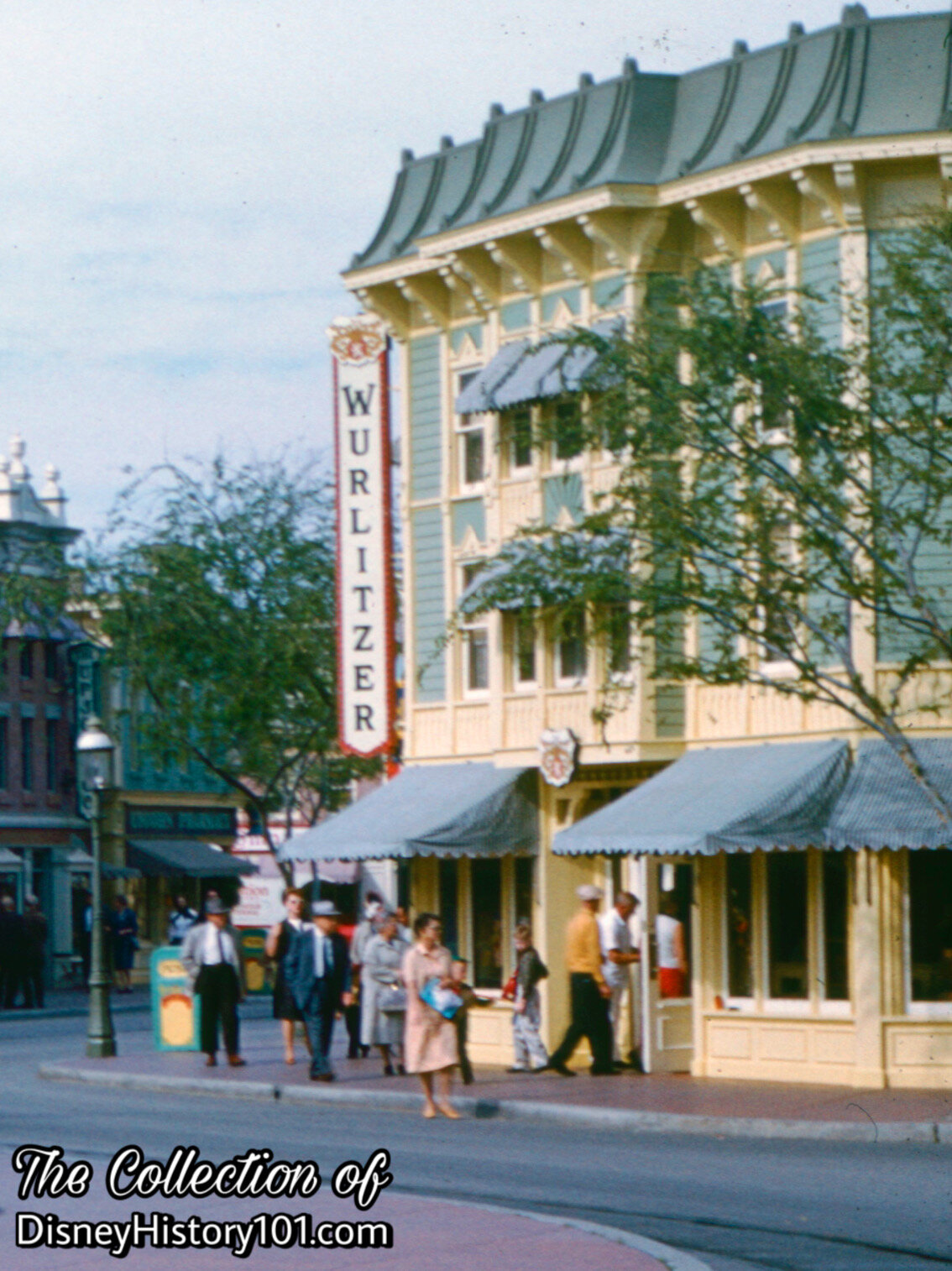

Now, “Disneyland is a place to have fun… and with the fun it is a place where you can learn,” according to “Disneyland, U.S.A.” (published 1958, for potential Participants). From 1955 to 1968, The Wurlitzer Company of Disneyland was home to a number of displays and exhibits. Once through the doors, guests could view “Wurlitzer’s Victorian and Modern Displays” (which were entirely separate features from “Wurlitzer’s Organs and Pianos” according to “Your Guide to Disneyland”, published 1955).
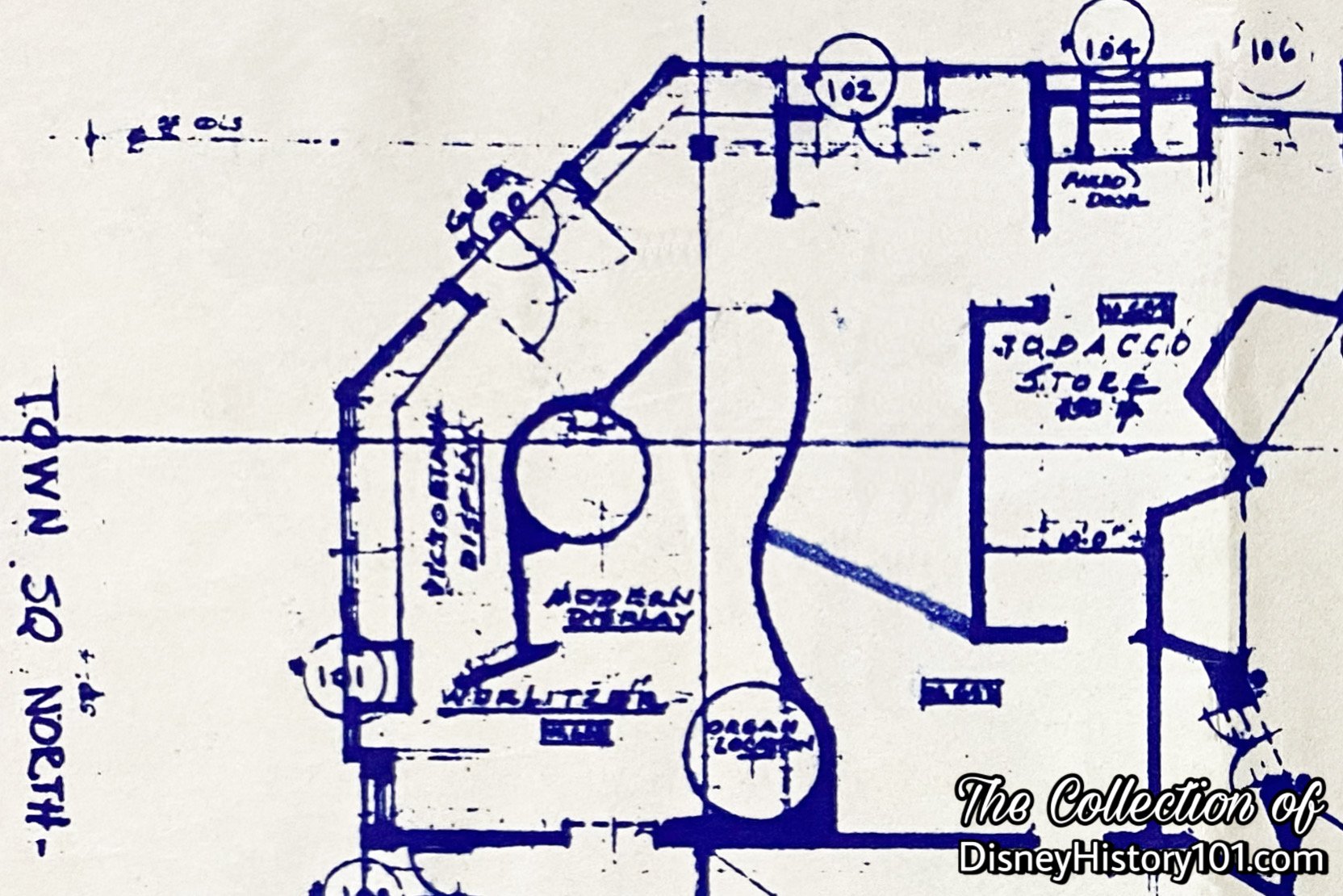
Window displays have always played an important role -communicating to guests the essence of a shop and were designed to invite guests into the store. These may be animated or still and would also include props used for display purposes. As early as 1955, (even from outside) guests could enjoy exhibits, like the Martin Band Instrument Company-sponsored window displays about “the role of band instruments in the good old days. One of the windows , all of which have dioramic type backgrounds, features…German Band figures…Other windows depict a musical professor and his pupil, a band concert, and a reproduction of band instruments being made in Martin’s original shop in 1904.”
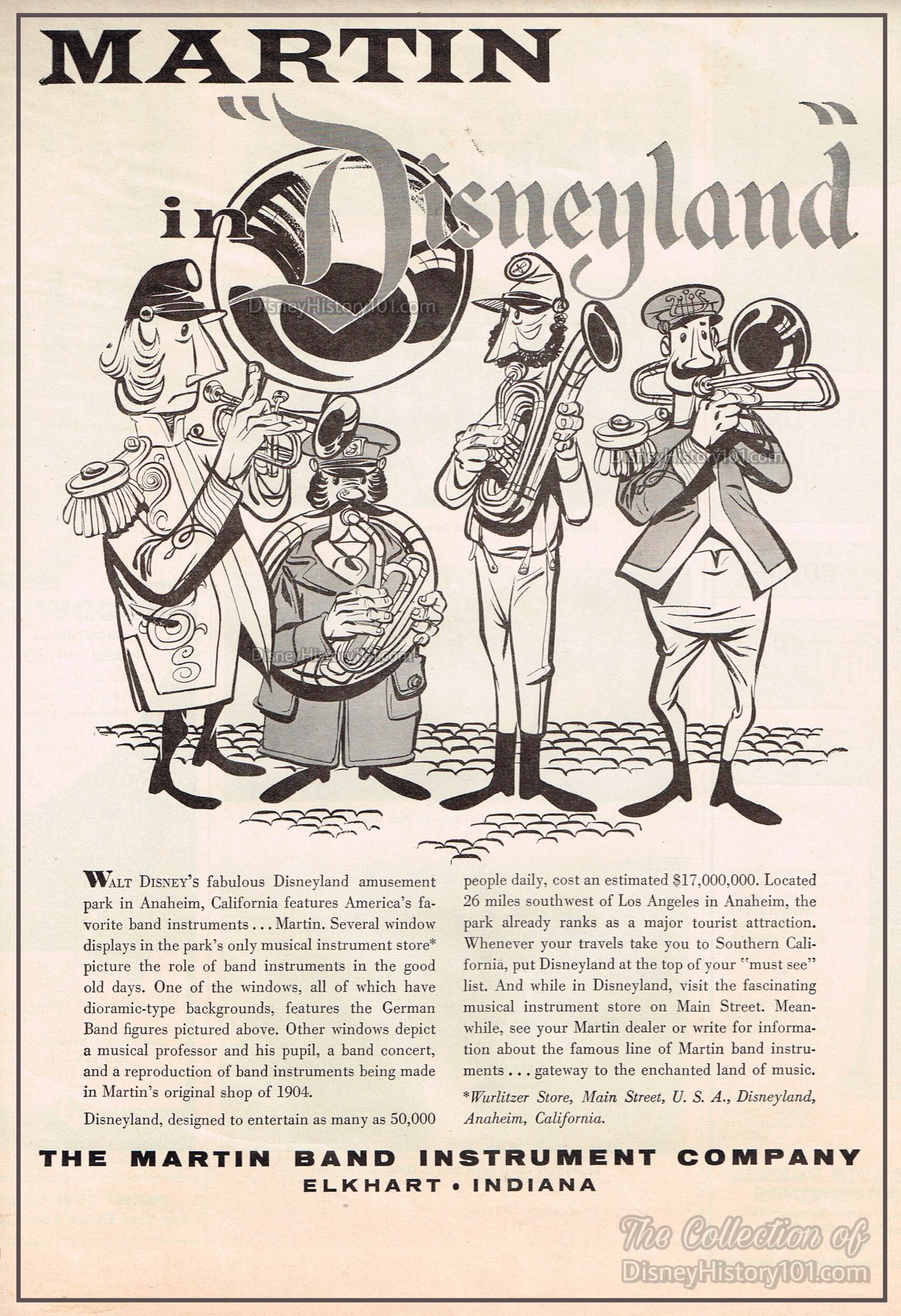
This Martin Band Instrument Company advertisement (published during the winter of 1955) preserves one of the Wurlitzer Music Hall’s early diorama window displays. Though the Martin Band Instrument Company was not a Disneyland sponsor, their products were sold through Wurlitzer Music Hall at Disneyland.
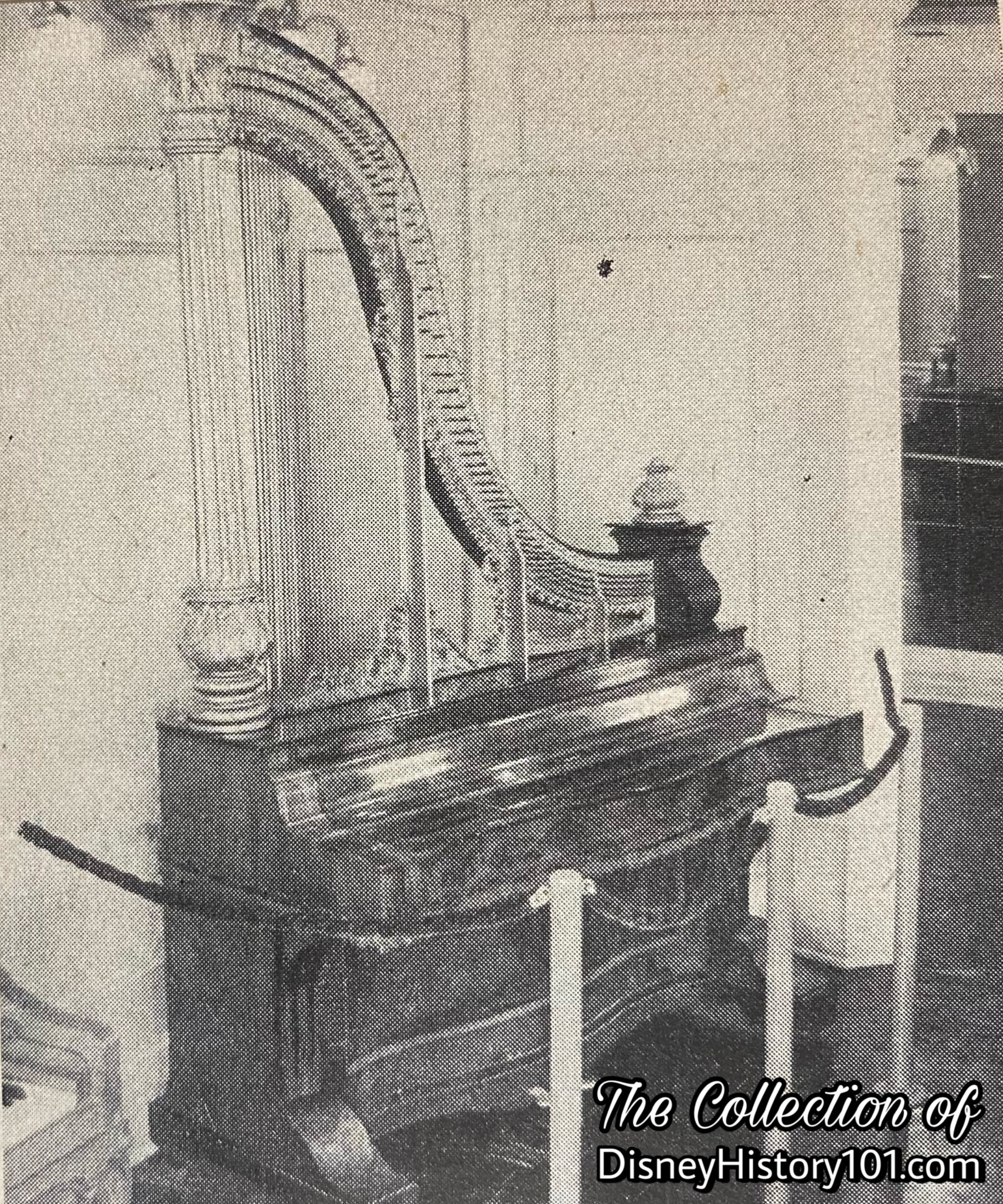
“Wurlitzer’s Victorian and Modern Displays” (similar in style to the neighboring Upjohn Pharmaceutical Company’s “Victorian and Modern” Exhibits) showcased antiques! There was a 1838/1837 black walnut Harp lyre Piano (1 of 3 known to exist in the United States; pictured below), a Melodian built 1869, and a Piananino (the predecessor of the modern day jukebox dating from 1905).
There was even a rare Orchestral Theater Pipe Organ “Toy Counter” which had the capability to produce sound effects, and was used during the silent era of film but scrapped when “talkies” came into existence. “As Dee explains the ‘Toy Counter,’ the first-class silent movie houses used Wurlitzer Orchestral Pipe Organs to accompany their feature pictures. Attached to these organs and op erated by toe buttons or keys was the ‘Toy Counter,’ which supplied amazingly realistic sound effects to accompany the music. The organist had at his com mand such varitoned effects as the bass drum, snare drum, kettle drum, castanets, tambourine, galloping horses, sleighbells, bird whistle, fire gong, door bell, and, for particularly dramatic moments, the crash cymbal. Very few of these ‘Toy Counters’ are still in existence. When the ‘talkies’ replaced silent pic-tures, most theater pipe organs were sold to churches. The sound effect machines had no place and were scrapped.”
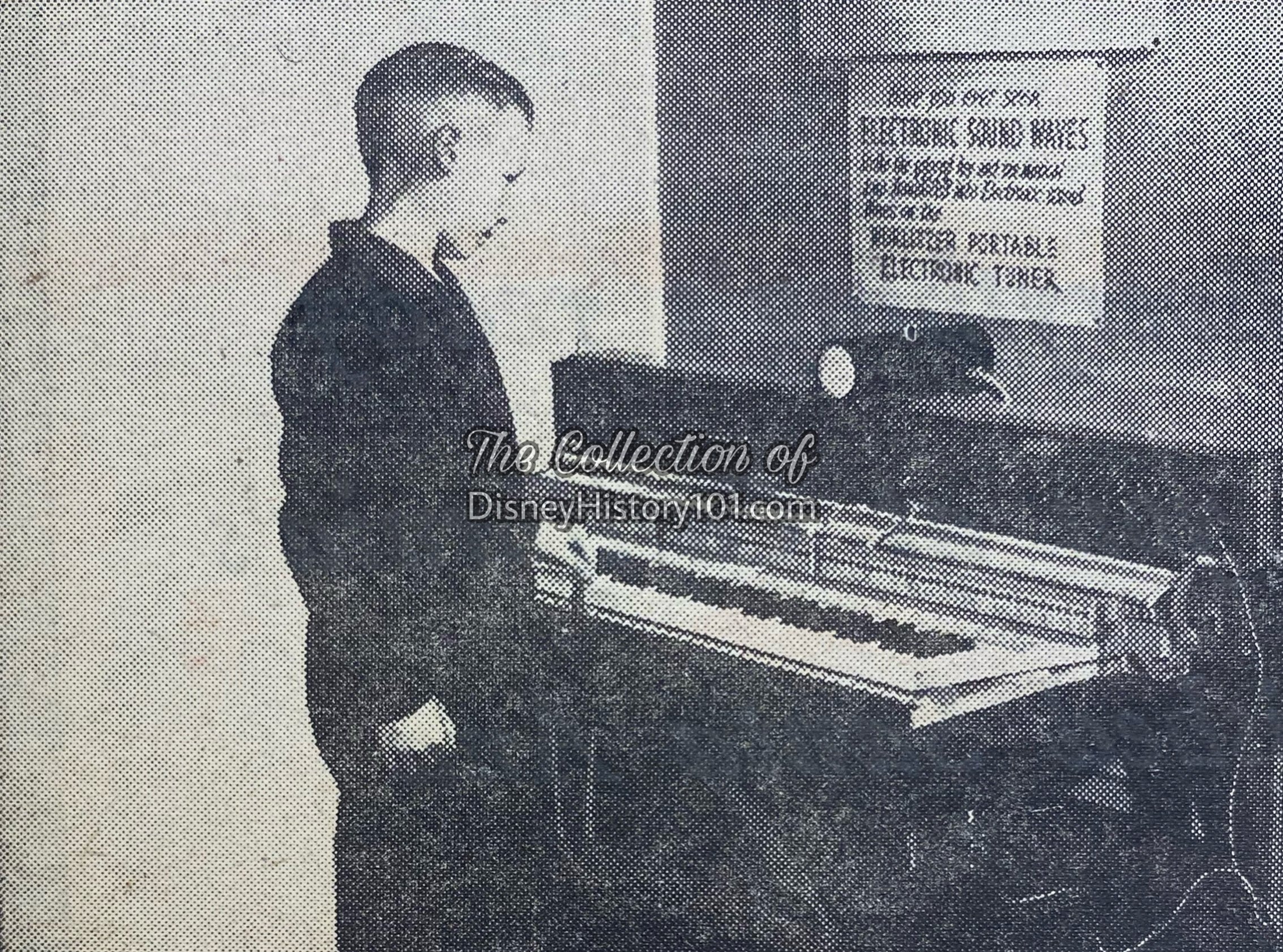
On the scientific side, there was a cutaway piano which allowed guests to “see as well as hear a piano note.” There was also an oscilloscope wired to a piano which distorted notes from the piano key into waving motions that looked similar to Fantasia’s “Meet the Soundtrack” Intermission segment. This was an interactive exhibit, which was so demonstrated for guests, that (according to Disneyland News, December 10, 1955), “Dee estimates that this key, a middle F note, has been struck some 3,500,000 times since opening day, July 18.” This is an impressive figure, considering that Disneyland attendance for that first six-month period was 1.9 million. All of these exhibits were valuable teaching tools for the teachers who would bring their students to Disneyland on field trips during the 1950s and 1960s. Considering all of these displays, it is easy to see why by the year 1958, the Wurlitzer Shop was considered one of 15 free educational shows and exhibits at Disneyland.
By 1969, these exhibits were among 15 old-time band organs and pianos at Disneyland, some of which dated back to 1890. There just weren’t any replacement parts for these rare antiques. So, ARCADE MAINTENANCE performed the necessary versatile, creative, and inventive mechanical repairs.

Wurlitzer created tangible memories for Guests through Merchandise and Show. Now, after perusing all these exhibits, Guests could test the grand piano, and peruse electric organs and pianos on display in the Wurlitzer Music Hall Showroom. Here, Guests could sample the merchandise - current Wurlitzer Co. Martin and Peddler brand pianos and organs. On display were also the newest 1955 Wurlitzer Electronic Portable Piano (a model that had its first west coast showing at Disneyland) and both new and traditional electronic organs. After looking over the models, Guests could acquire information about aforementioned sponsor (the Martin Band Instrument Company of Elkhart, Indiana). Finally, Guests could purchase pianos, organs, and jukeboxes from the Wurlitzer Music Hall.

In the alcove of the wall, you’ll notice a 2800 series Wurlitzer Jukebox Arcade, carrying hi-fidelity and stereophonic sound. One of Wurlitzer’s popular models was a jukebox with a 200-song capability. If guests couldn’t take one home, the jukebox was licensed as a small coin-operated souvenir bank that was also sold in Wurlitzer Music Hall.
Wurlitzer was renowned for its jukeboxes and phonographs, and many other models appeared on the showroom floor - the Wurlitzer Centennial Model 1900 (1956), the remote controlled Model 5207 “Wall Box” with a 104-song selection (1956), to name a few. Wurlitzer also manufactured and sold a number of “Corner Speakers” and “Wall Speakers”in a variety of attractive colors, for high acoustical efficiency! With so much to offer it isn’t surprising that Wurlitzer would soon come to be billed as “the official music of Disneyland” during its era!
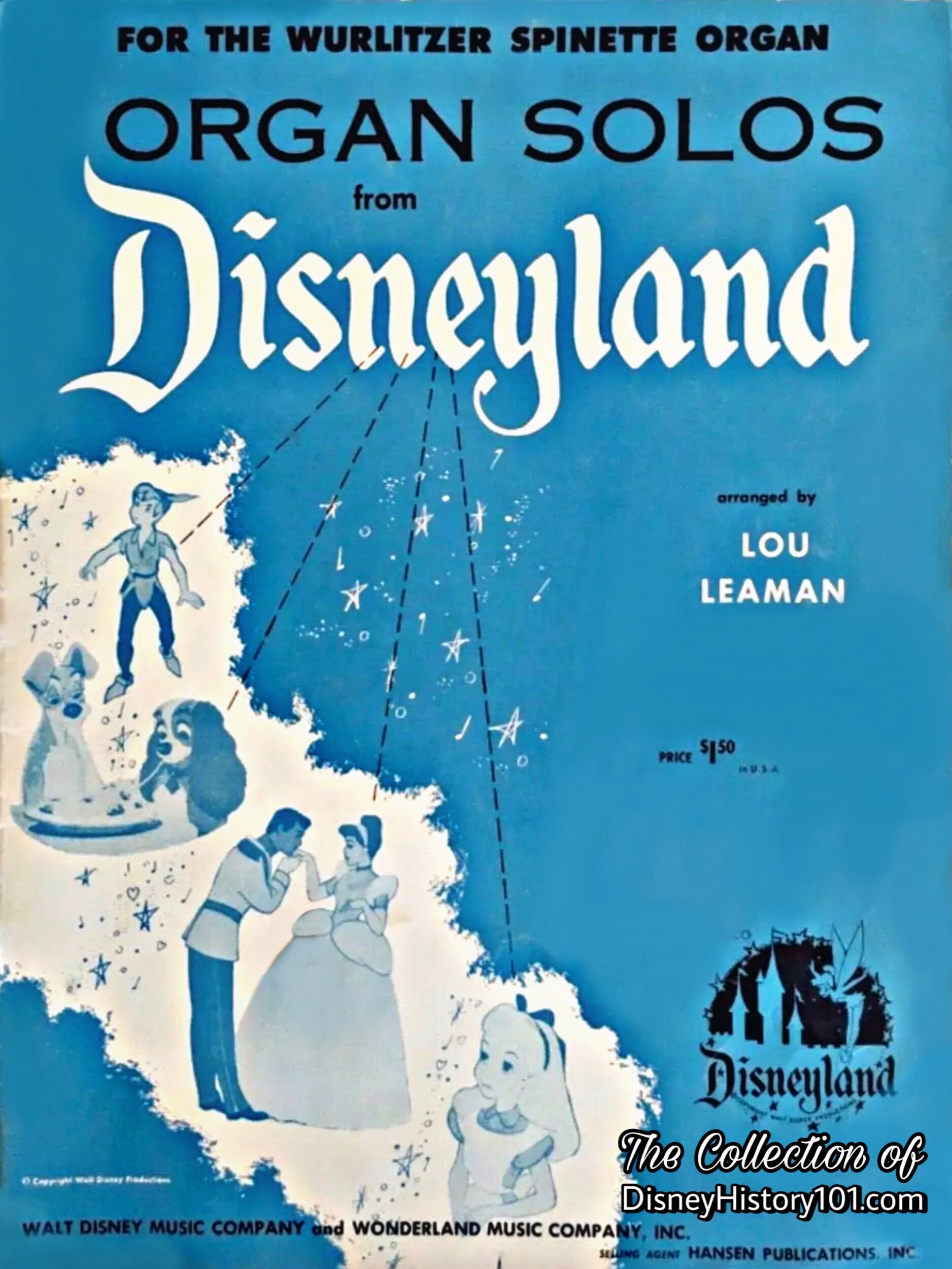
During the era of the Wurlitzer Music Hall at Disneyland, Wurlitzer publications (like the ones pictured above and below) were available for purchase through the Wonderland Music Company (next door to Wurlitzer Music Hall). Some sheet music was produced with the intent of being played on certain models (like the Spinette), while others were published for all Wurlitzer Organs. It’s likely that sheet music like this may have been available for demonstration to guests of Wurlitzer Music Hall at Disneyland!
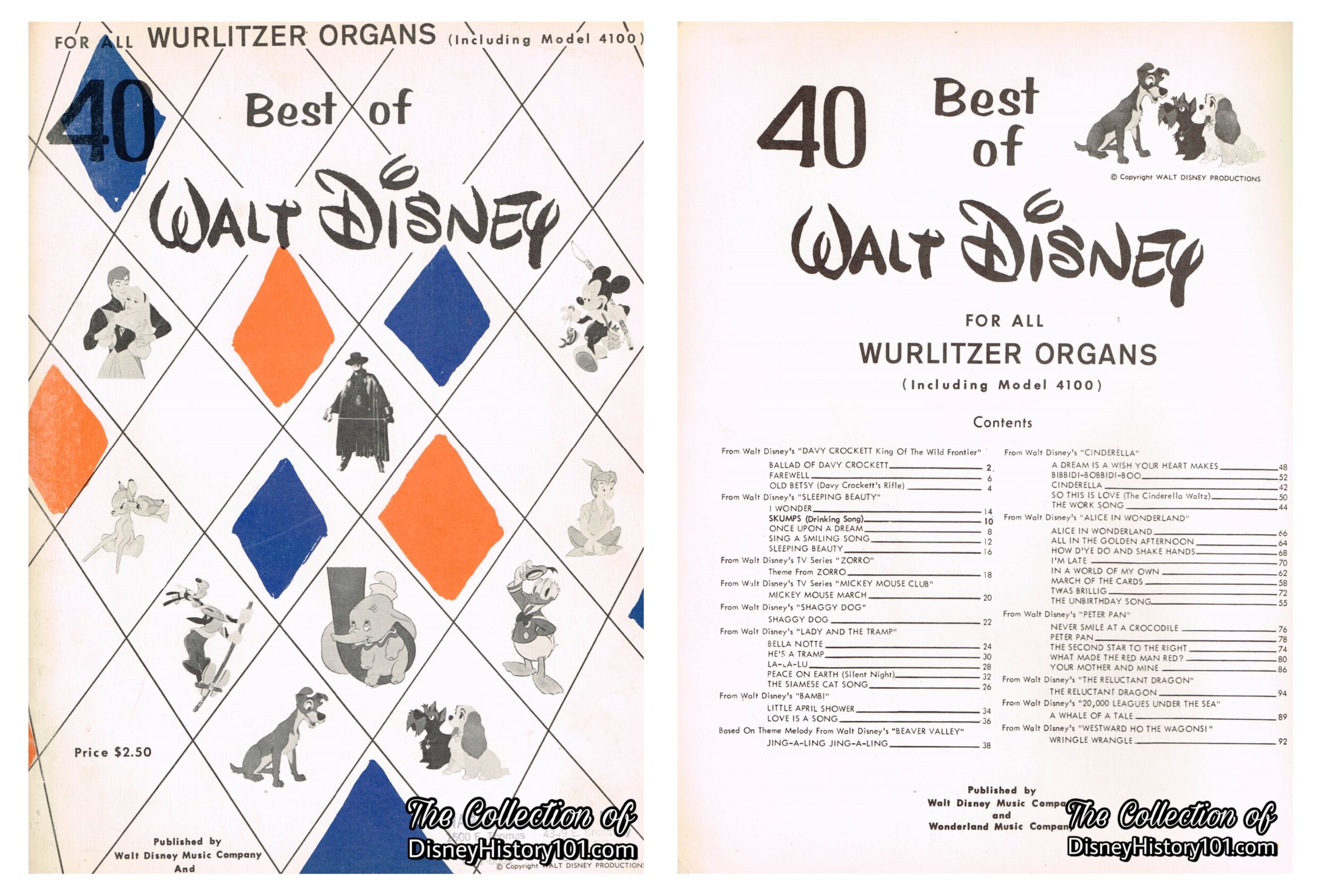
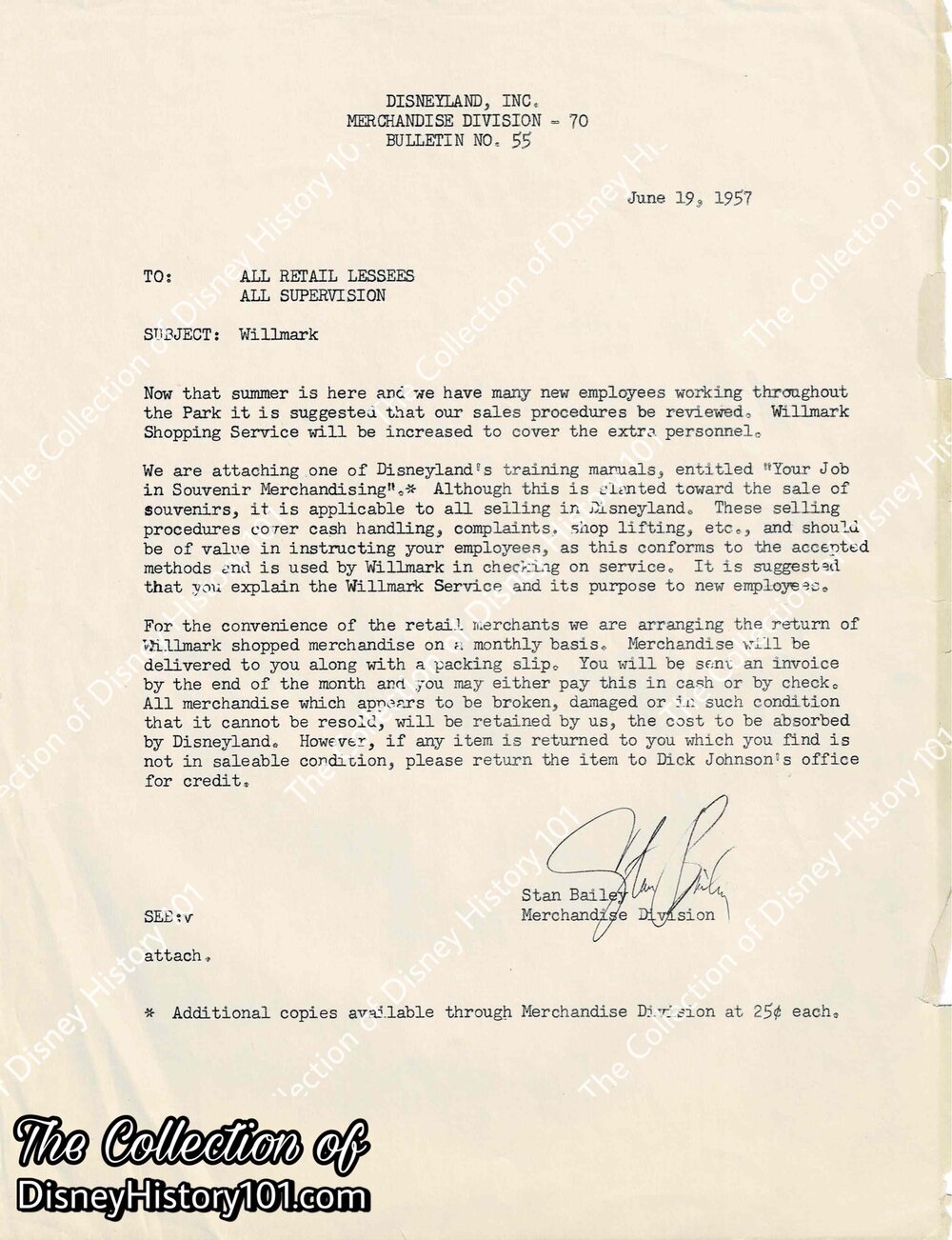
Few other smaller souvenirs like lighters featuring the Wurlitzer name and slogan “The Name That Means Music to Millions” were also briefly sold in the shop!
The 1957 TWA brochure “Let’s Talk About… My Visit to Disneyland, Anaheim, California: A Note from Mary Gordon TWA Travel Advisor” mentioned: “We learned that to fully explore Disneyland takes two days, so early next morning we were at the gates of the park again. The second day we spent more time shopping in the 50 inviting shops, and the youngsters bought inexpensive souvenirs to take home to friends.”
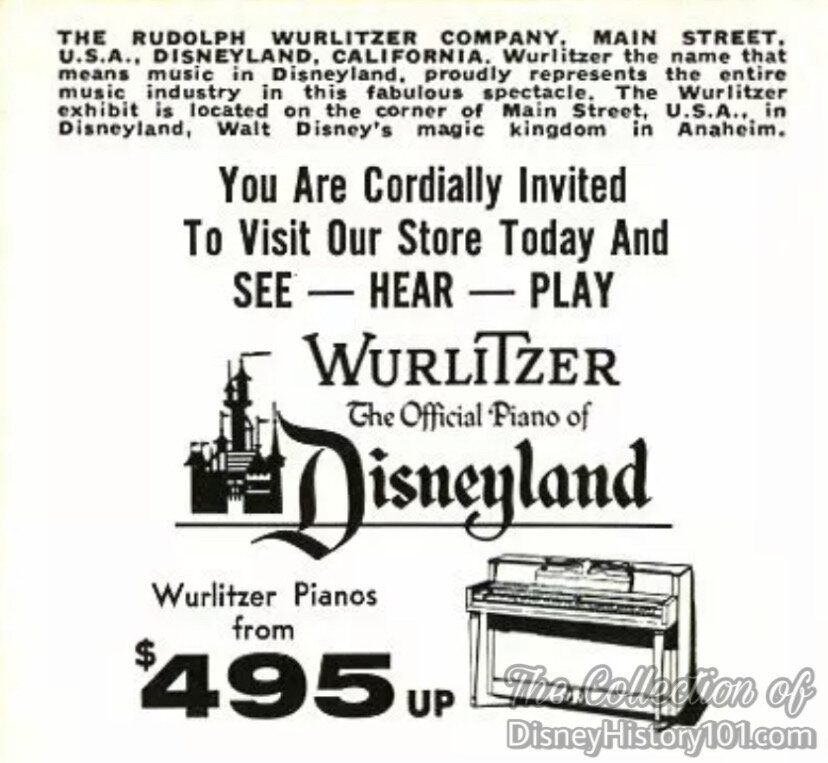
What was the price range advertised for Guests and potential customers of Wurlitzer of Disneyland? The backs of souvenir postcards (pictured above) advertised the starting prices of Wurlitzer pianos. This is a prime example of “the possibilities for a sponsor to capitalize on this association” with Disneyland. The many ways of “merchandising, sales promotion, advertising, public relations and publicity programs are almost limitless. Regardless of the type of product, goods or services manufactured and marketed by sponsors, the Disneyland association can be effectively and importantly translated into the sponsor’s promotional activities,” according to “Disneyland, U.S.A.,” published 1958. The corporate synergy was good. Institutional lessee The Wurlitzer Company yielded some revenue for Disneyland Inc. - $16,253 for the fiscal year ending September 29, 1957 and $19,717 for the fiscal year ending September 28, 1958.

“…And Now A Word From Our Sponsor!”
Wurlitzer was more than a free exhibit at Disneyland. Wurlitzer was “a name that means music to millions” (as this advertisement attests). The company was (and is still) known for its organs and pianos “for church and home,” yet the Rudolph Wurlitzer Company of Tonawanda, New York also manufactured violins, flugelhorns, trumpets, saxophones, guitars, and more! Wurlitzer even manufactured the Music Laboratory Instructor Console (pictured above), which was utilized by high schools, colleges, universities, and other institutions of learning around the country. The Wurlitzer people were always happy to demonstrate one of their fine pianos, organs or stereo consoles - whether guests were just relaxing or furnishing a mansion.
In addition, Wurlitzer offered instructional publications (like the “Wurlitzer Hobby Lesson Course”) - accelerated pop and piano courses compatible with the Wurlitzer Music Library. Soundtracks of Walt Disney Productions were piped through the speakers (e.g. as during May of 1957 when guests could take a listen to the new Studio sound track releases of Bambi and Cinderella).
The Wurlitzer Music Hall at Disneyland even played a part in at least one National Piano Teachers Day event held in Disneyland on October 10, 1959.
With so much to offer it isn’t surprising that Wurlitzer would soon come to be billed as “the official music of Disneyland” during its era!
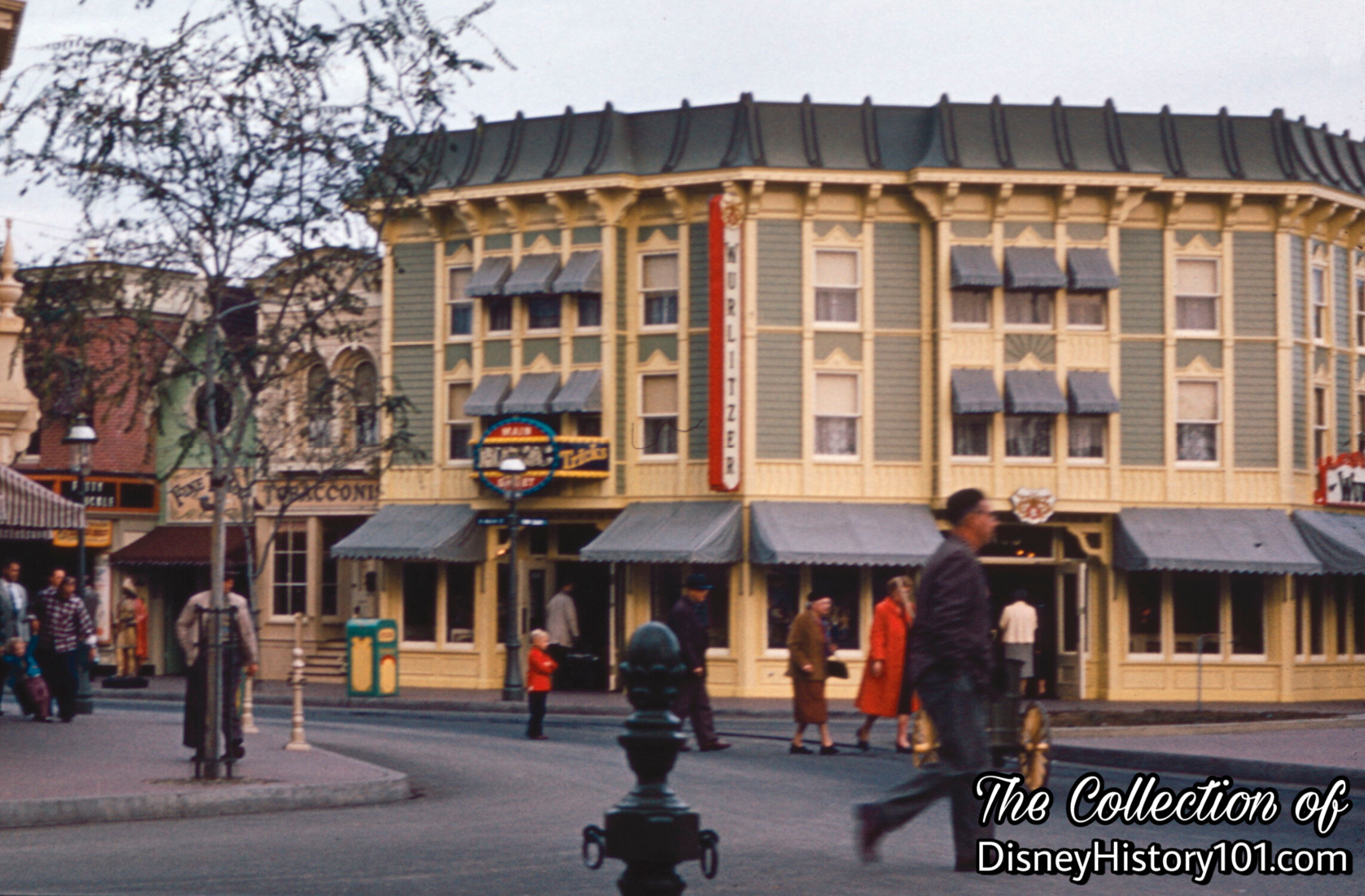
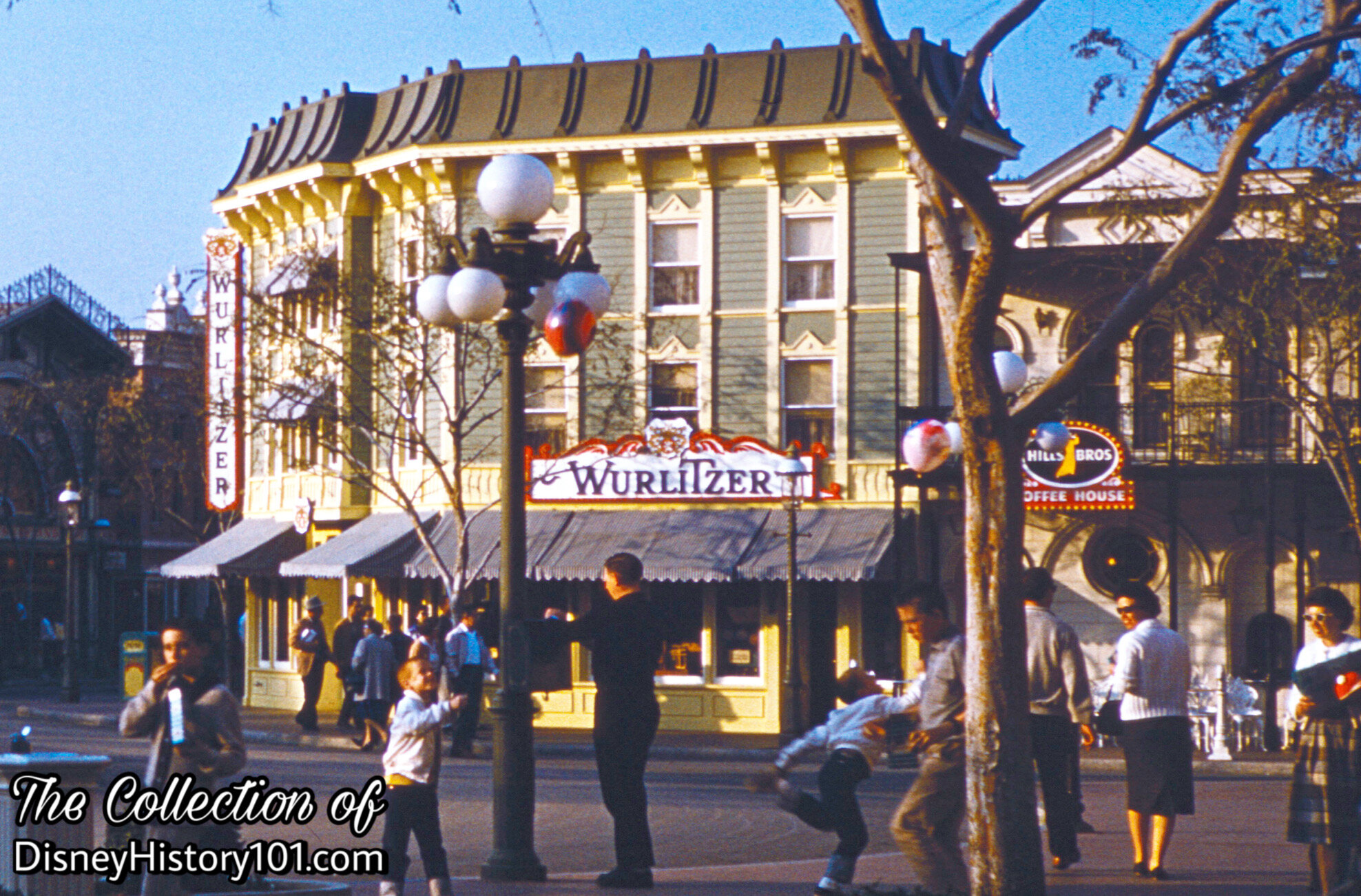
By October of 1959, the company was (1) of over sixty-eight other firms playing a vital part in the team effort to bring happiness to Disneyland’s Guests. Some were small, specialized individual operators; some were huge companies such as Swift & Co. - the Bank of America - United Paramount Theaters (which you hear as UPT) - Carnation - Richfield - General Dynamics - Crane - and many others. These companies used the park to publicize their wares, leased space in the Park to sell their wares, and Disneyland collected advertising fees from them.

Since the beginning, Disneyland was a miracle of showmanship in many ways! According to “THE DISNEY THEME SHOW - an introduction to the art of Disney outdoor entertainment”: “Important are the sounds which permeate the scene, for without them, the theme show is a silent movie . . . but with them it is a symphony of music, effects, and natural sounds that the finest stereo system in the world can't duplicate. These sights and sounds are provided not only by imagineered attractions and shows, but also through the multi-talented efforts of live entertainers . . . in special musical groups . . . in parades and pageants . . . providing an everchanging backdrop to virtually every area in the theme show.”
Atmosphere Entertainment complimenting the theme of areas was staged to entertain Disneyland Guests on an immediate and personal level. You may recollect hearing a concert emanating from inside the Wurlitzer Music Hall (or, even right outside it’s doors), as you strolled by during a peak season. As mentioned earlier, Wurlitzer was appropriately located “down the street” from Wonderland Music Company, where guests could purchase sheet music of popular songs featured in Walt Disney Studios feature length films and television programming. Much of this sheet music was demonstrated for guests by skilled “Hosts”and “Hostesses” (both managers and employees) of the neighboring Wurlitzer Music Hall.
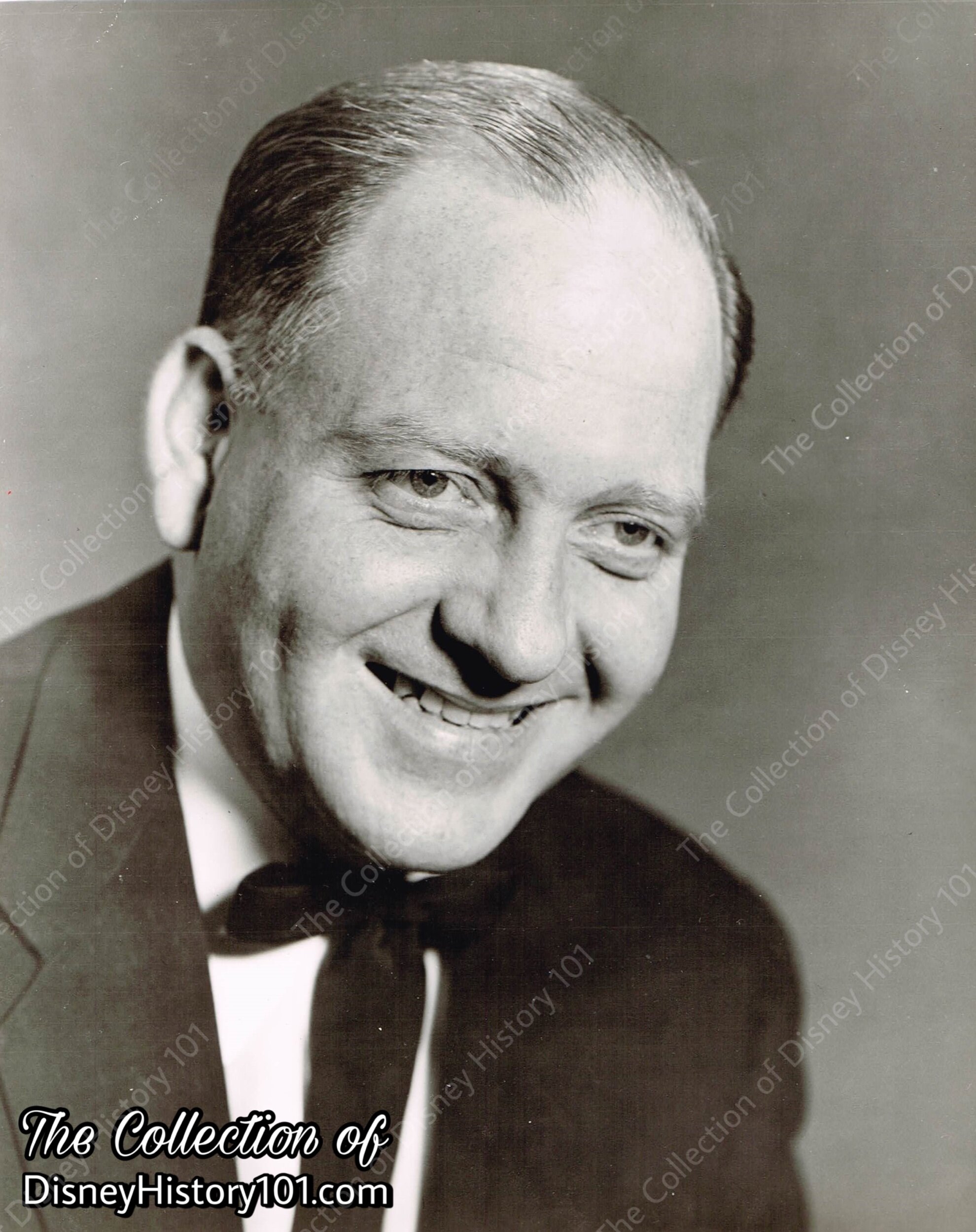
“Dee Fisher Takes You to Disneyland”
What better way to sell a product than to demonstrate it for guests? That was exactly what Wurlitzer and Martin and Pedlar, representative Dee Fisher was well known for since 1955 - his recitals inside the Wurlitzer Music Hall (also referred to as the “Wurlitzer Exhibition”). It’s been said that “Disneyland is People,” and Dee was the Wurlitzer manager and certainly the “genial host,” often surrounded by the audiences of each new day whom he personally welcomed into the store. More than that, Dee was creating magical moments for Disneyland Guests. This is evidenced by a photograph, featuring Dee giving one of his concerts, that was featured on the cover of Wurlitzer Organ Review Magazine alongside Mickey Mouse and Minnie Mouse during the late 1950s.
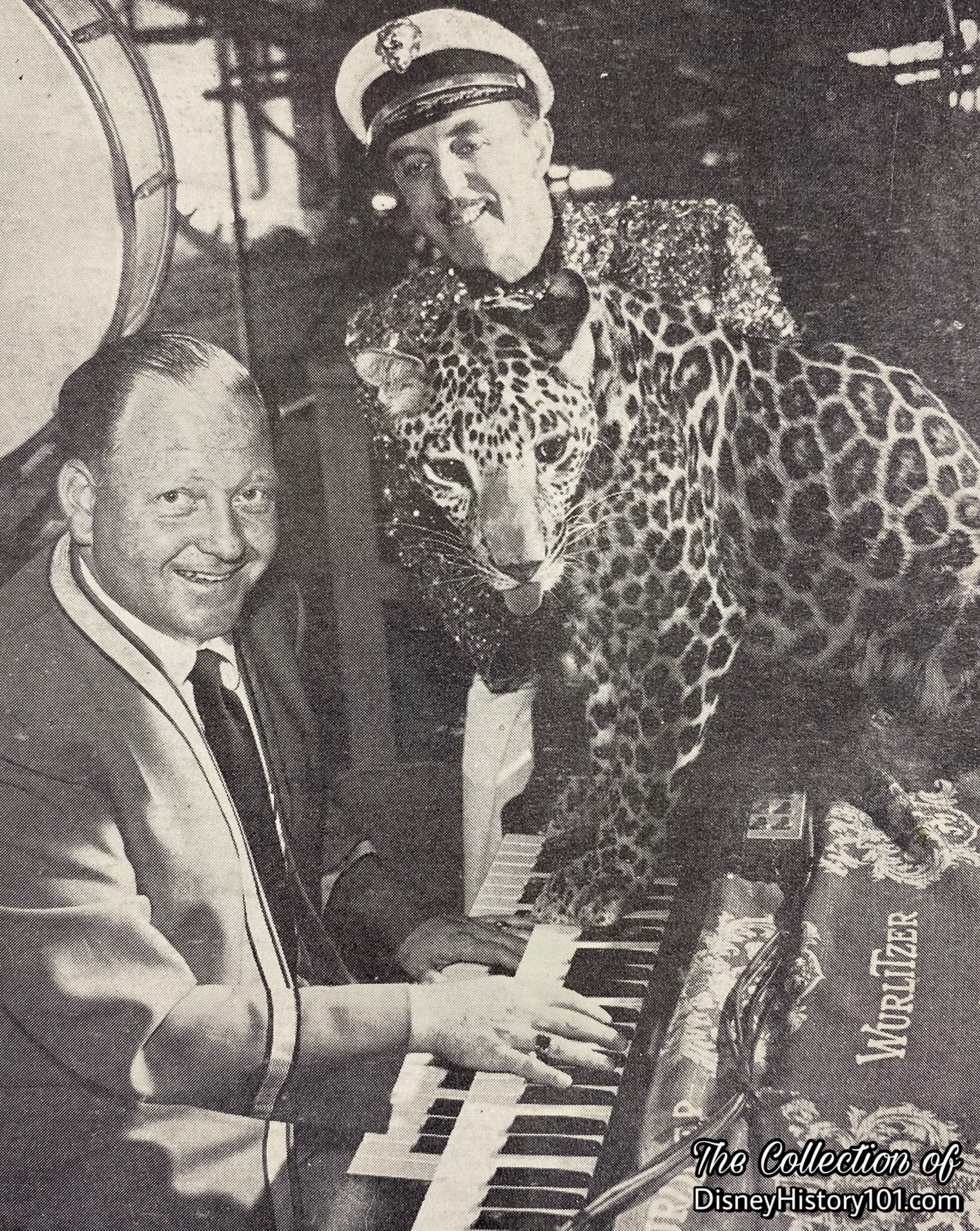
Dee even performed at other locations at Disneyland. For instance, when the popular Mickey Mouse Club Circus headlining act, “Keller’s Jungle Killers” was held over from February 19, 1956 to September 9, 1956, Dee Fisher (of Wurlitzer) provided background music on a Wurlitzer Organ, according to “The Disneyland News” [Vol. 2, No.2 ; published for August, 1956] Dee flew to the Hawaiian Islands to play the mighty Wurlitzer for George Keller's Animal Act between Christmas of 1956 and New Year's Day of 1957. Dee Fisher’s first LP album was recorded on the electric organ in Disneyland, soon released after the first of the year.
Dee Fisher fulfilled the important role as the second president of the Disneyland Merchant's Association (following the term of Les Wagman of the Bank of America), announced at a meeting held on January 25, 1956. However, like most other Disneylanders, Dee enjoyed DRC activities during his free time. Dee served as the Disneyland Toastmasters Club President from 1956 to 1957. Speaking of DRC activities, Disneylander area merchant Wurlitzer was a sponsor of the championship Disneyland baseball team of 1957.
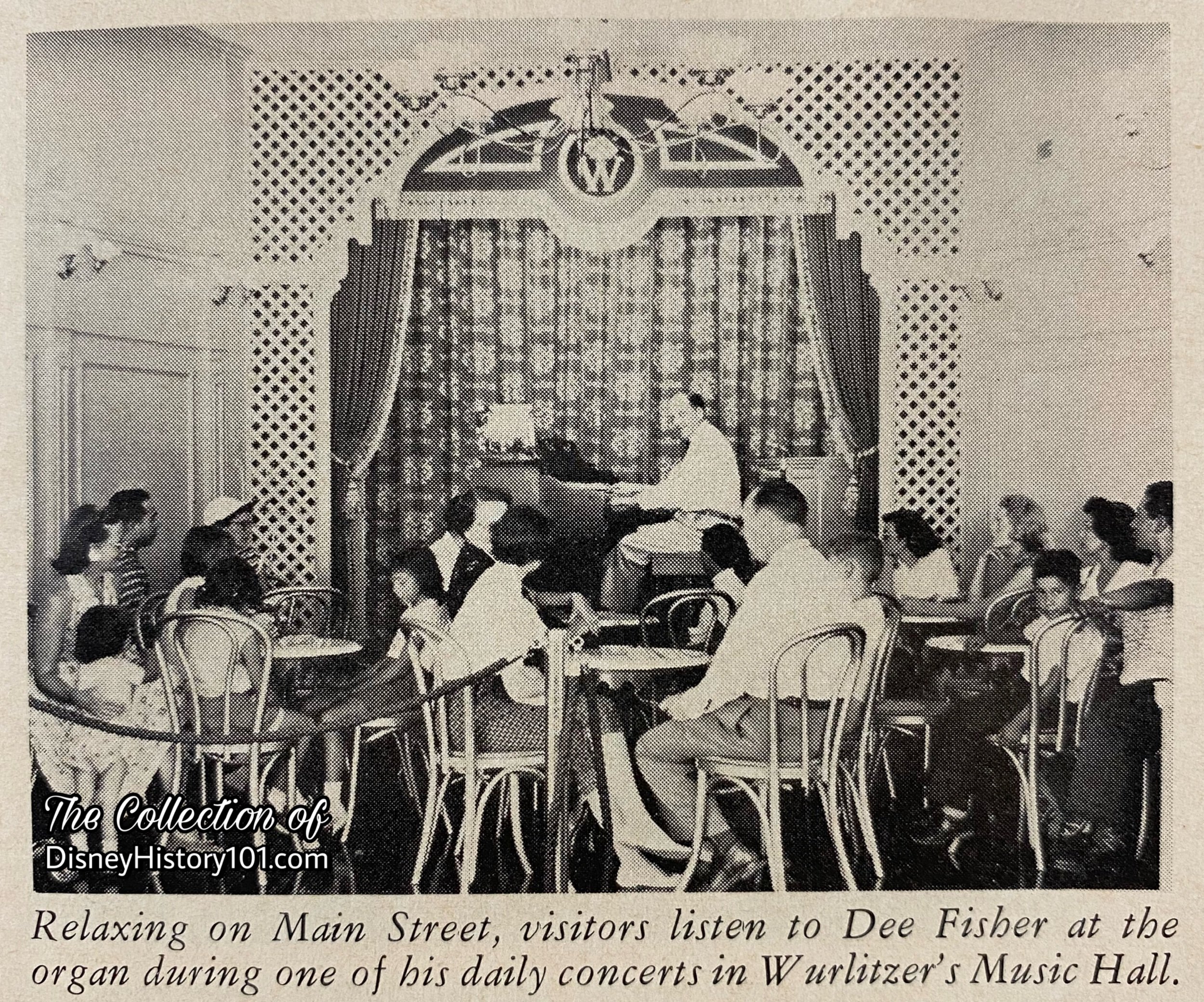
During 1957, Wurlitzer Music Hall received a major redesign and refurnishing. One product of the redesign - Wurlitzer Music Hall’s small stage (surrounded by tables and chairs) - is rarely seen captured on film, however one picture (seen above) is preserved in Disneyland Holiday magazine, published June of 1957, on page 7. The article advertised the free attraction: “Like organ music? Latest free entertainment added on Main Street is the newly redesigned and refurnished Wurlitzer Music Hall. Dee Fisher, talented performer on the Wurlitzer organ, entertains several times daily with relaxing concerts. You can also hear Dee late in the afternoon when his concerts are broadcast over Disneyland's public address system.”
These performances were still popular by the winter of 1957, as evident by an article published in Vacationland magazine (Winter 1957-1958) mentioning “Wurlitzer organ music concerts by Dee Fisher” among the Park’s “lively musical shows presented free of charge.”
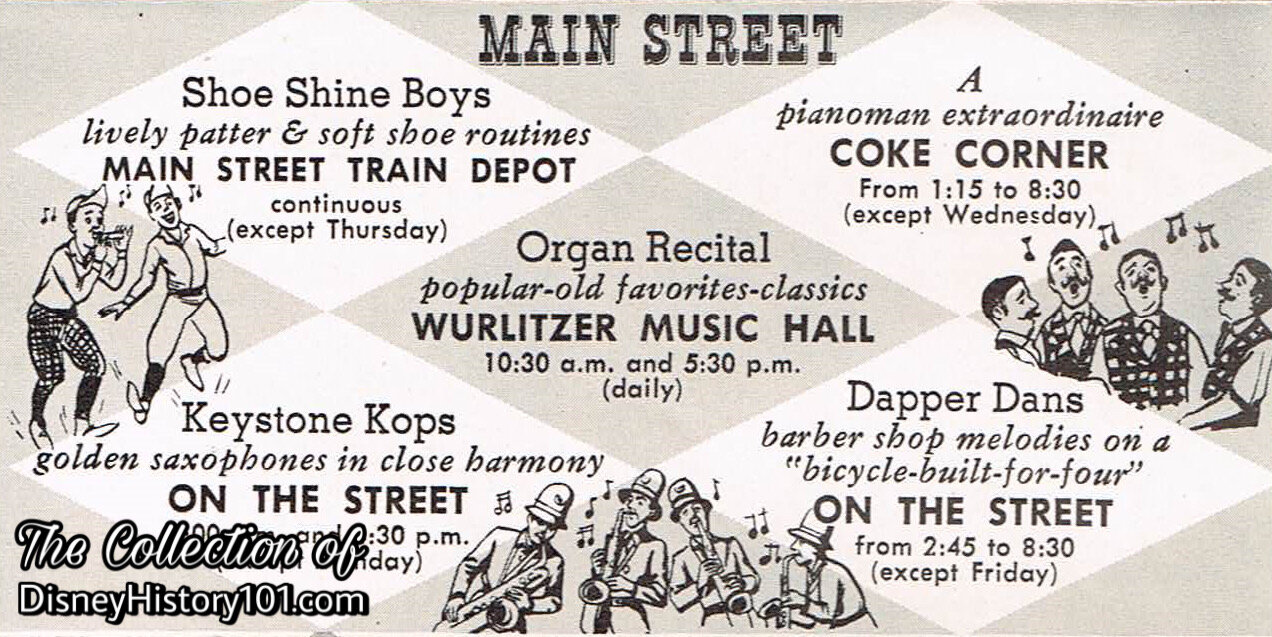
During the 1960s, Entertainment Guides continued to regularly advertise the “Organ Recital - popular-old favorites-classics” often performed by Wurlitzer Manager D. R. “Dee” Fisher, in the Wurlitzer Music Hall, several times daily at both 10:30 a.m. and 5:30 p.m. These tunes were still piped through the shop via Grado Lab “Jr.” wall mounted speakers, and were once even “broadcast over Disneyland’s public address system” during the late afternoon, according to one article published in Disneyland Holiday (Summer, 1957).
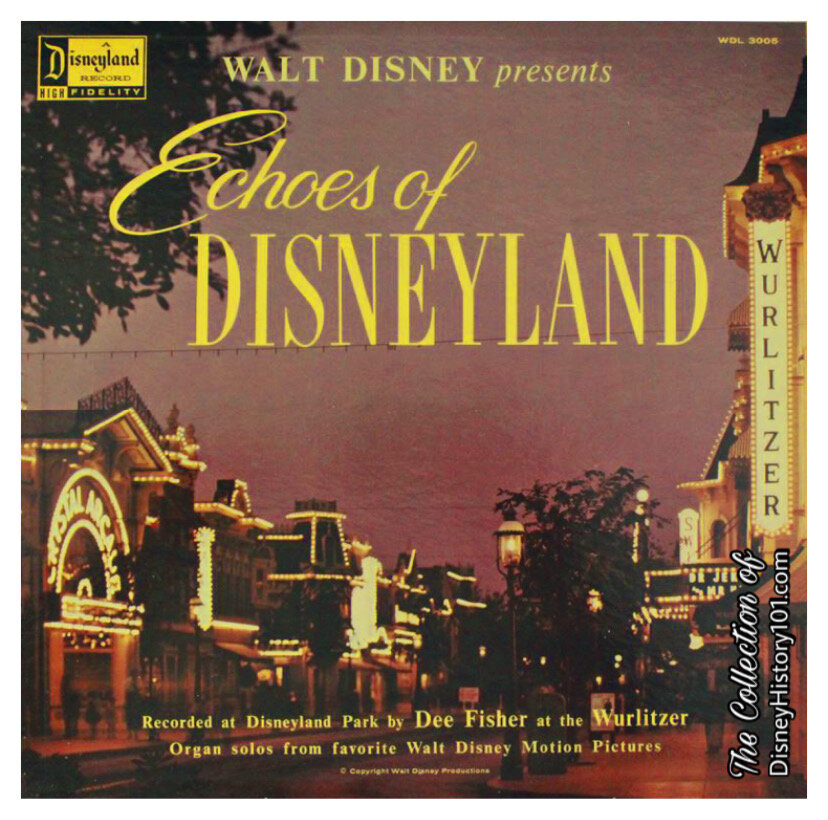
“Quiet Please, Broadcasting In Disneyland”
Thirteen of Mr. Dee Fisher’s electronic organ solos were even recorded and released on a “High Fidelity” album - “Echoes of Disneyland” published thru Disneyland Records, 1957. This practice of Disneyland’s featured artists (like the Strawhatters, the Yachtsmen, and others) recording albums was commonplace during the 1950s and 1960s. All of Dee’s recorded album tracks are renditions of popular songs once featured in Walt Disney Productions theatrical releases :
(1) Second Star to the Right (Peter Pan)
(2) Little April Shower (Bambi)
(3) A Dream is A Wish Your Heart Makes (Cinderella)
(4) Blue Shadow on the Trail (Melody Time)
(5) Bella Notte (Lady and the Tramp)
(6) La La Lu (Lady and the Tramp)
(7) Some Day My Prince Will Come (Snow White and the Seven Dwarfs)
(8) When You Wish Upon A Star (Pinocchio)
(9) Two Silhouettes (Make Mine Music)
(10) Lavender Blue (So Dear to My Heart)
(11) One Song (Snow White and the Seven Dwarfs)
(12) Alice in Wonderland
(13) Love is A Song (Bambi)
Guests who were interested in bringing the sound of “the happiest place on earth” home with them, could find Dee’s fine-quality and Hi-fidelity album for sell at the Wonderland Music Shop next door. Owning to Dee’s record album, his reputation as a “celebrated West Coast organist” preceded him, even outside Disneyland. The photograph of Dee (pictured above) was given as a personal gift (upon request) to the owner of Larry Bray’s Organ Loft of Salt Lake City, Utah in 1962.
In addition to Dee, other entertainers occasionally performed for Wurlitzer Music Hall guests, like the Dapper Dans. The Disneyland Christmas Carolers (under the direction of Dr. Charles C. Hirt and lead by Mr. Robert G. Hasty), were also known to perform at “Wurlitzer” during various times of the day, from December 16th, 1967 thru January 1st, 1968. [“Disneyland Holiday Talent Master Schedule,” prepared for the period of December 16, 1967 through January 1, 1968]
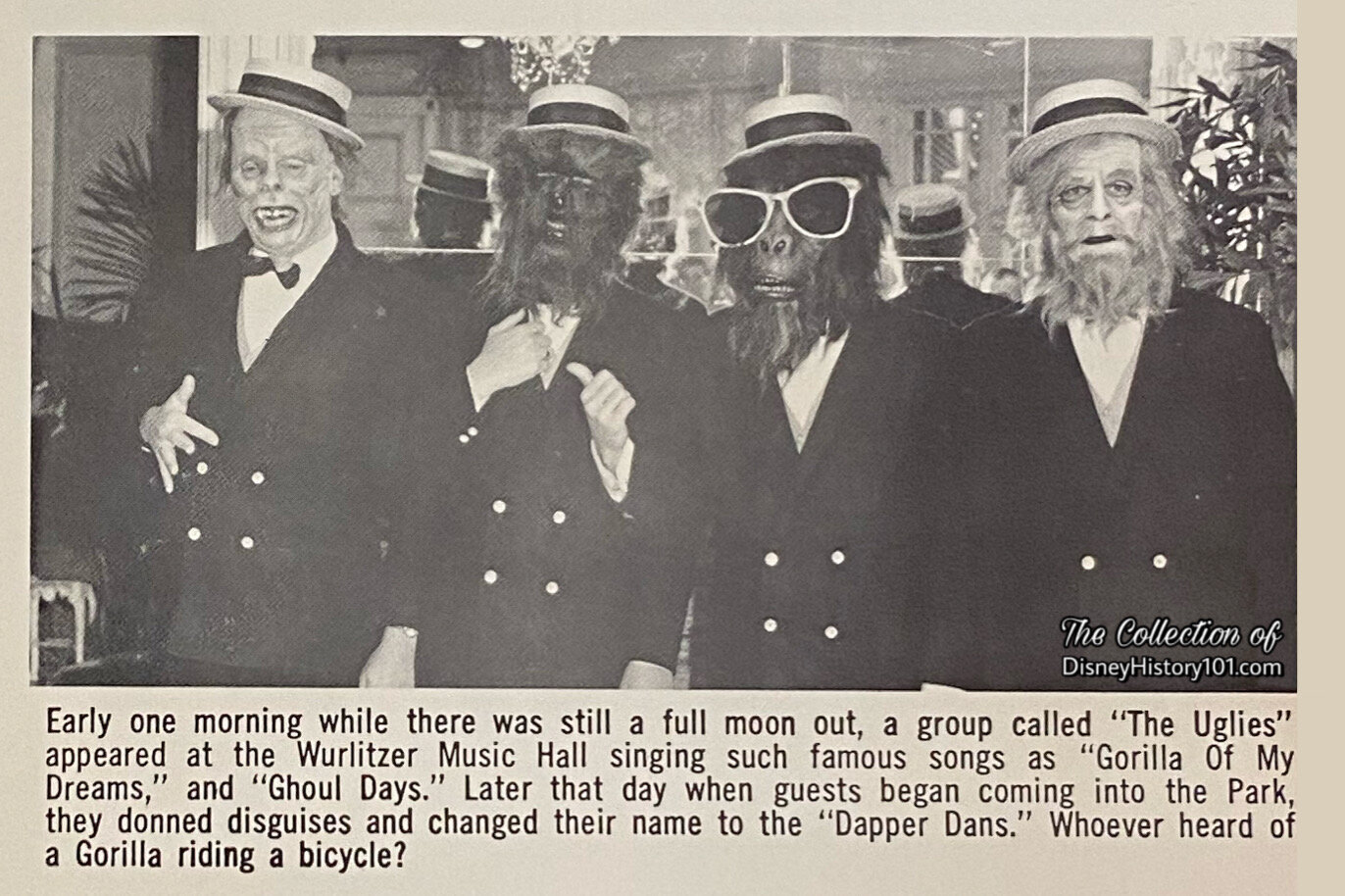
Dee wasn’t the only one to cut an album. Wurlitzer Music Hall Manager Mr. Don Beamsley (pictured earlier) recorded an album with Jud de Naut and June Rudell in 1962. This he did while working two jobs, one which was performing piano concerts for guests in a demonstration of popular organ models in the showroom. Wurlitzer Manager Don Beamsley was also known to be “the life of the party” and also occasionally performed at the Gourmet Restaurant with his group, as well as locations outside Disneyland. As far back as the Winter of 1962, he also performed at Hurrah’s of Lake Tahoe.
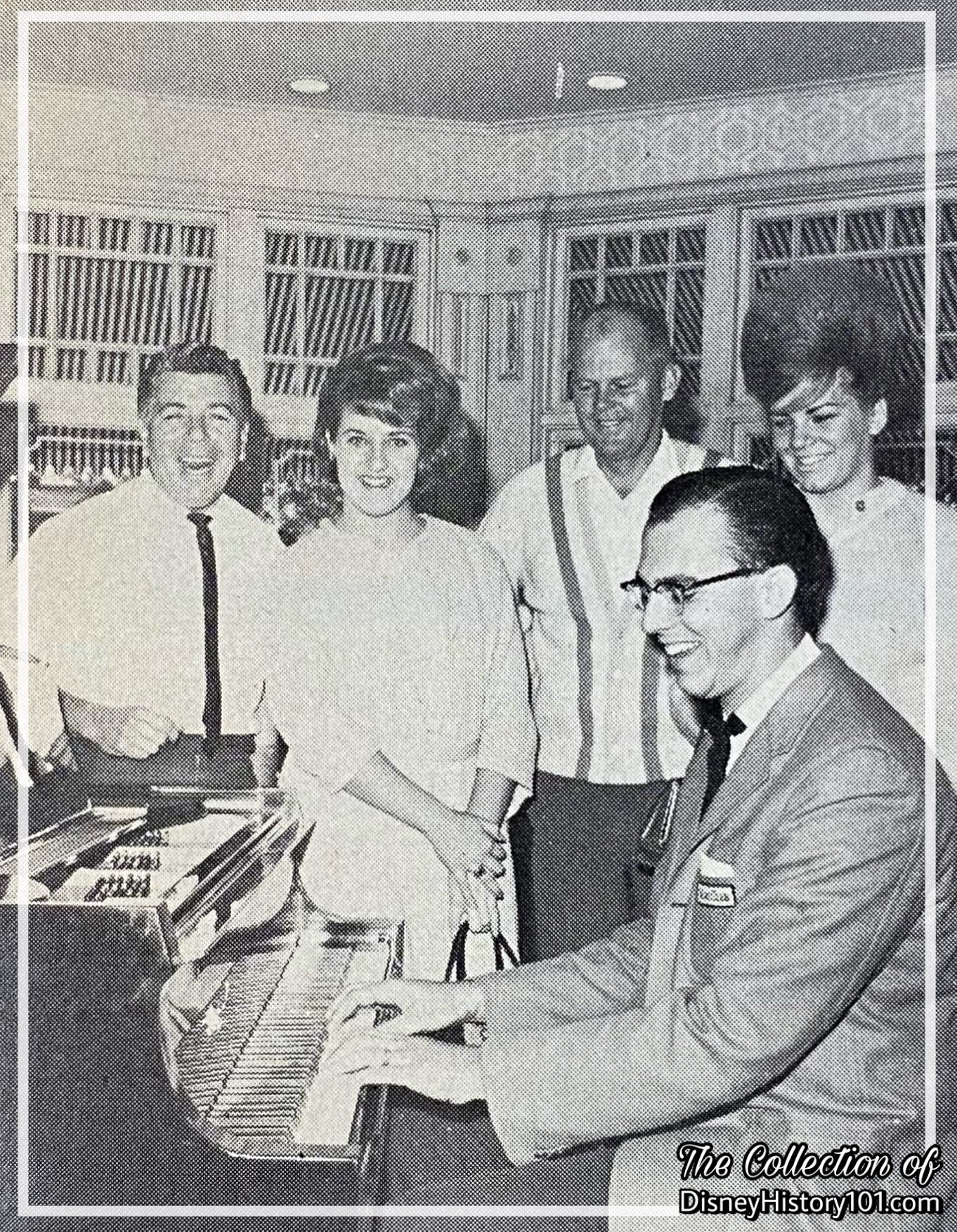
Many photos of Don Beamsley (and friends around a Wurlitzer piano) were published in coordination with the Disneyland Tencennial Celebration, for various newspaper inserts and publications like Vacationland magazine (Winter/Spring, 1965).
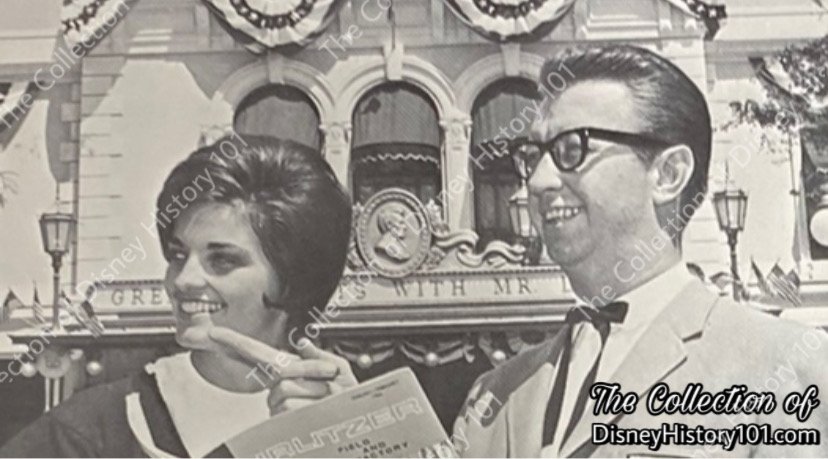

In another rare unpublished view of Wurlitzer Music Hall, Manager Mr. Don Beamsley and Hostesses Carol Williamson.

In a rare (unpublished press photograph) “Vintage View” of Disneyland, (left to right) we see Z.B. Ross, (Wurlitzer Music Hall Owner and Manager) Mr. Don Beamsley (Disneyland Wurlitzer Music Hall Owner and Manager), and Walt Peteet standing for the camera in Town Square!
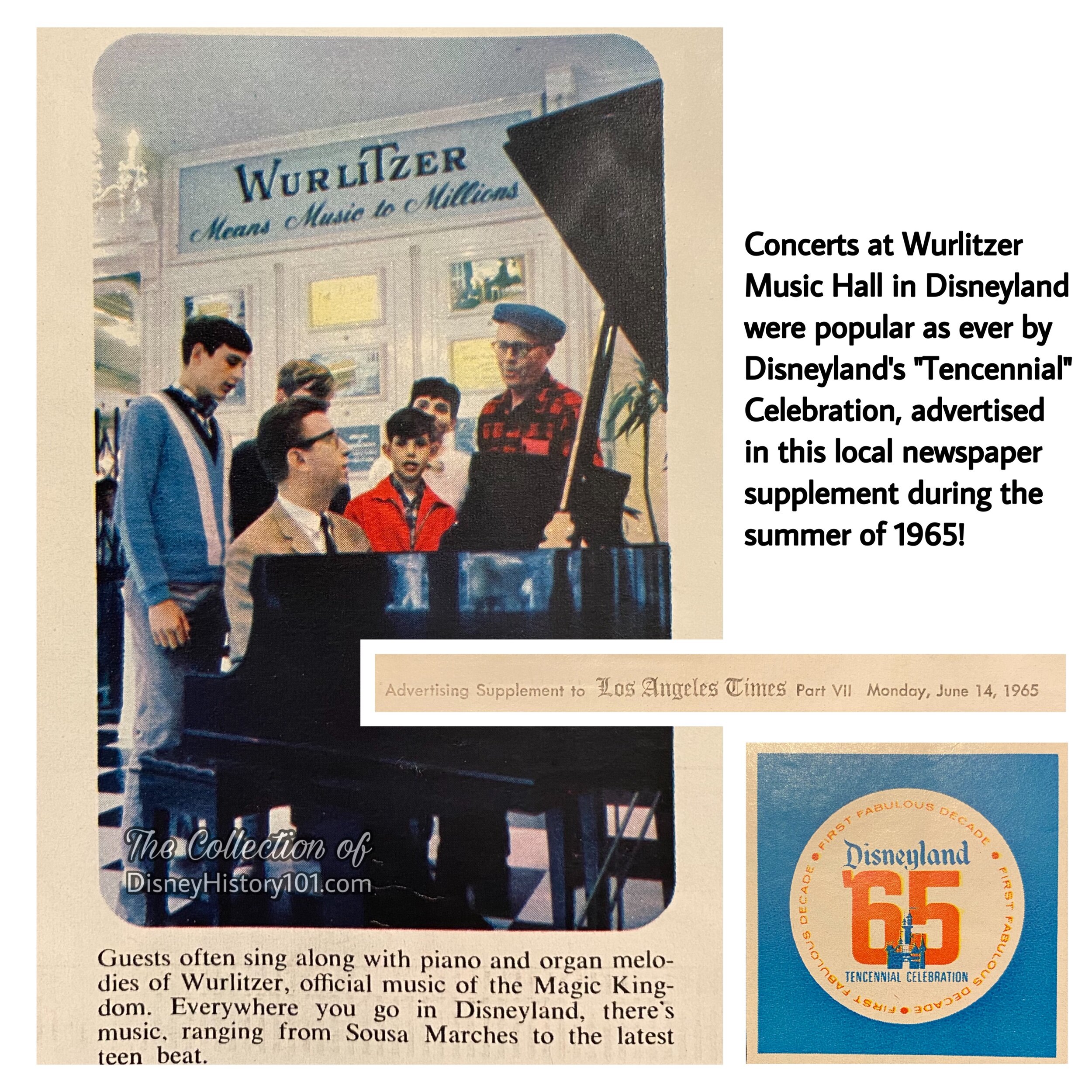
Sometime after the previous photo was prepared for the Tencennial insert, Mr. Don Beamsley began his career playing the organ for Dodger Stadium, during August of 1966 (before the World Series was held).
While the Wurlitzer name was associated with Disneyland, Disneyland did not exclusively make use of Wurlitzer brand pianos for its Shows. For instance (on October 19th, 1966), a meeting was held with Brian Whitman (of Whitman Piano Company) over the “purchase of piano dollys, rehab of pianos and purchase of a Grand Piano and other accessory equipment for Disneyland,” according to the recollections of Ben Harris. Then there is the story of the German J.C. Neupert harpsichord (or “Fortepiano”), which was hand-picked by Lillian Disney from the Kasimoff Blüthner Piano Company of Los Angeles, for Club 33.

Walt’s 65th birthday fell on December 5, 1966. It was about this time, that the unexpected occurred, ten days later, on Thursday, December 15, 1966, at 9:35 a.m., when a brother, a friend, and a leader, Walt Disney passed. Many Disney personnel who were present, remember this tragedy. Soon after, Roy O. Disney, President and Chairman of the Board of Walt Disney Productions addressed the staff with an official statement, in which it was conveyed:
“Walt Disney spent his entire life and almost every waking hour in the creative planning of…Disneyland… and the other diversified activities that have carried his name through the years. Around him Was Disney gathered the kind of creative people who understood his ways were always unique and he built a unique organization. A team of creative people that he was justifiably proud of… Many have been with us for over thirty years. They take great pride in the organization which we helped to build. Only through the talent, labor and dedication of this staff could any Disney project get off the ground… Much of Walt Disney’s energies had been directed to preparing for this day. It was Walt’s wish that when the time came he would have built an organization with the creative talents to carry on as he established and directed it through the years. Today this organization has been built and we will carry out this wish. Walt Disney’s preparation for the future has a solid, creative foundation. All of the plans for the future that Walt had begun… the expansion of Disneyland… will continue to move ahead.” Even Walt was so confident in his people to “move ahead,” once stating in a Canadian broadcast interview: “I think they’re going to stay with that policy because it’s a good business policy… I think they’ll hang on… well after Disney.”
Despite the loss of Walt (and all the competition), the Wurlitzer show went on - their organs were still popular around Disneyland during the winter season of 1967. If you visited Disneyland at that time, you may recall the sound of festive holiday “Organ Concerts” emanating from Carnation Plaza for 3 shows daily (10:30am-12:00N), from December 16th, 1967 thru January 1st, 1968 (except December 24th, 25th, and 31st, 1967). “Guests dining at the Garden Plaza” would “be entertained by the beautiful sounds of the Wurlitzer organ featuring Ray Whitaker at the keyboard.” [“Disneyland Holiday Talent Master Schedule,” prepared for the period of December 16, 1967 through January 1, 1968]
Alas, during September of 1968 (some three years after this previous photograph was taken ; a little over 13 years after the Wurlitzer name was first associated with Disneyland), the opening day sponsor departed from Disneyland. There were no comparable sponsors to fill the void left by this unique shop and free exhibit, and thus no “echoes” to be heard of the Wurlitzer name in Disneyland.
It was about this time (1968), that a new exhibit was in the planning stages, “Walt Disney - A Legacy for the Future.”
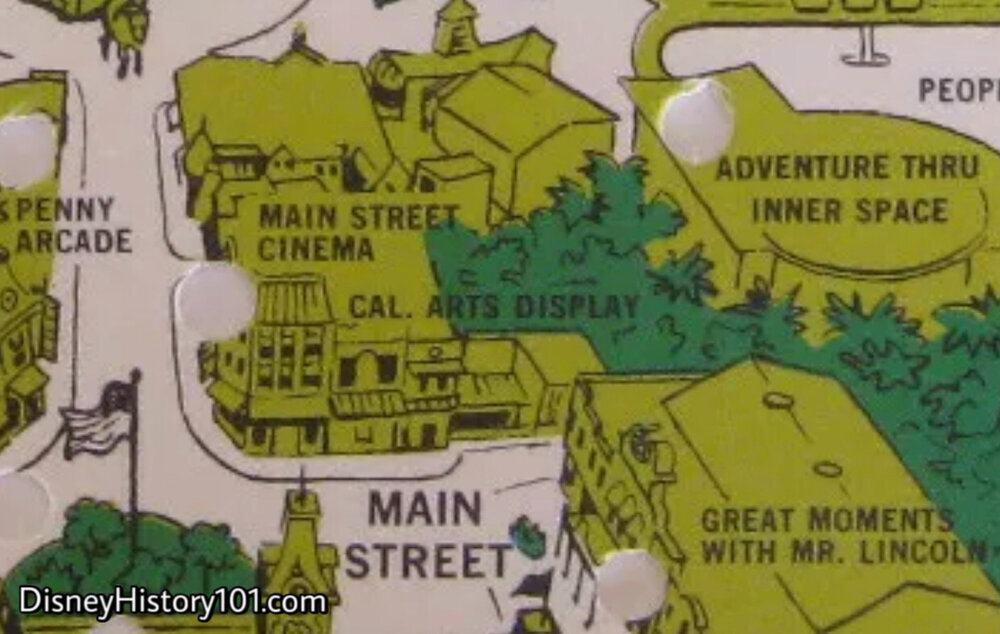
Note the “Cal Arts Display” in this location c. 1970. Disneyland now utilized the vacant space to present special Park and company-related exhibits, beginning with “Walt Disney - A Legacy for The Future” (which opened January 15th, 1970). Walt Disney - A Legacy For the Future was an unstaffed “multi-screen show and display presenting Walt Disney’s endeavors in the fields of art and education. Included are plans for his cherished dream, California Institute for the Arts, and the first public display of all 29 Academy Awards received during his lifetime.” The exhibit would also display some “208 other awards,” according to Disneyland Line.
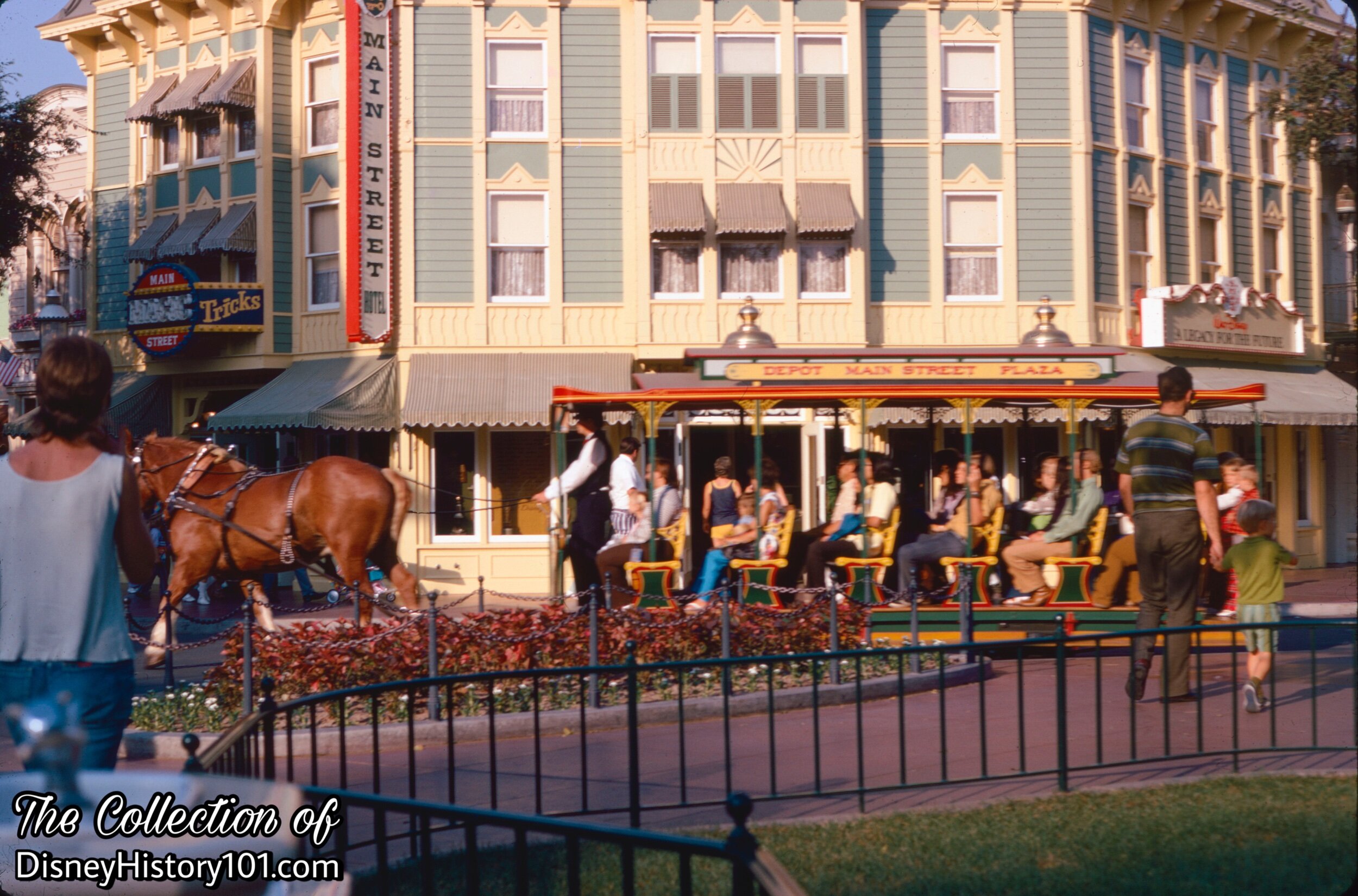
By the summer of 1972, Walt Disney - A Legacy for the Future was still reckoned as one of Disneyland’s Free Exhibits and Shows (meaning that no admission coupon was required for entry). The Walt Disney Legacy for The Future” exhibit included artifacts like Walt’s special Academy Award for Snow White and the Seven Dwarfs.
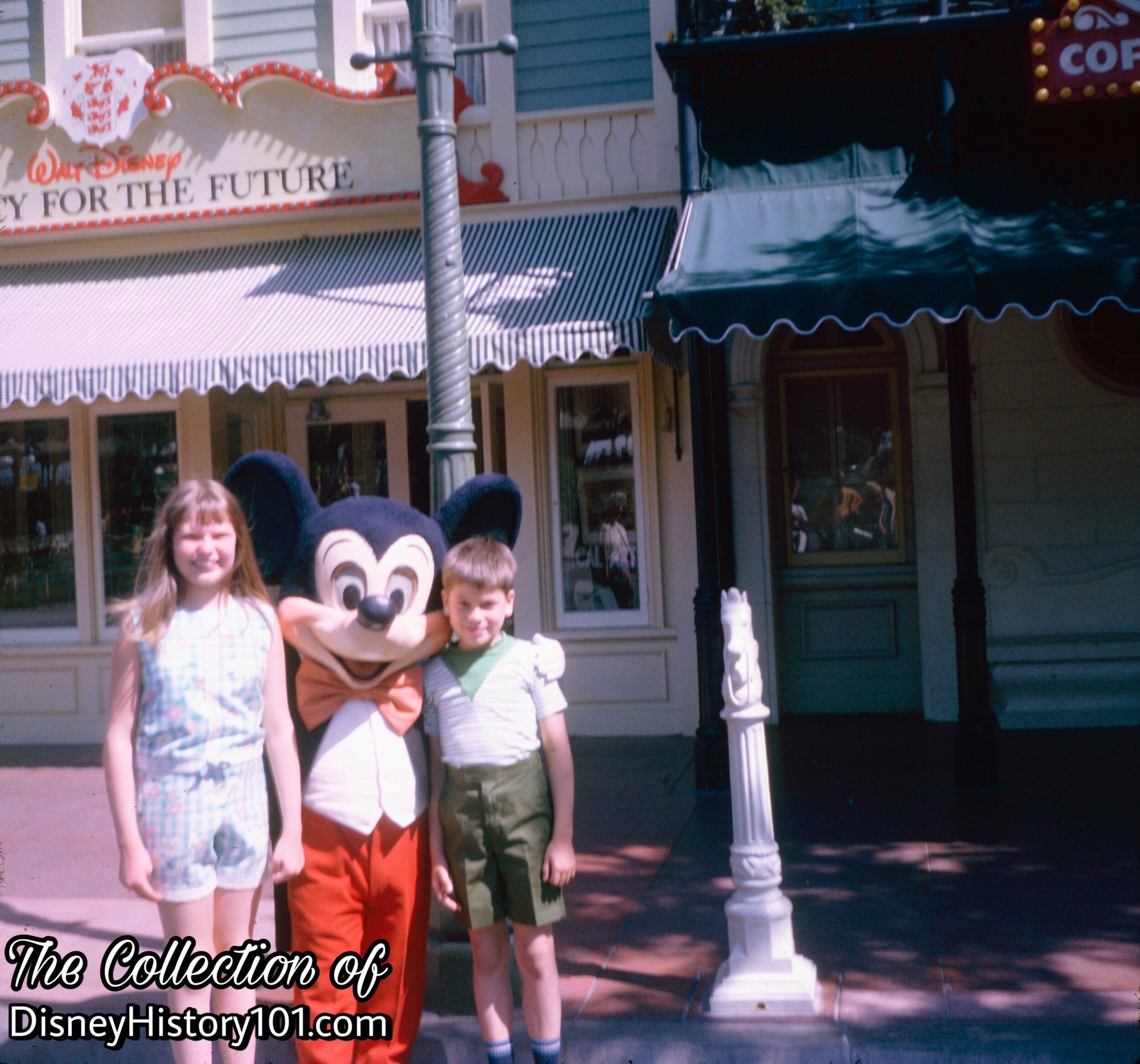
After "Walt Disney - A Legacy for the Future" closed, another exhibit opened - “Disneyland Presents a Preview of Coming Attractions” (also known as the “Disneyland Preview Center” and the “Disneyland Showcase”), for some 15 years, from October of 1973. The free exhibit featured “artists renderings and models of future attractions planned for Disneyland,” as well as “other Corporate projects such as Tokyo Disneyland or the Disney Channel,” according to Disneyland LINE Magazine, September 5, 1985 ; Vol. 17, No. 36. You may recall seeing models, renderings and videos of “coming attractions” like Captain EO, Discovery Bay, Splash Mountain, the Hall of Presidents (for Disneyland), America Sings, Space Mountain, and New Fantasyland on exhibition. Other exhibits showcased films, Disney television shows, and Disney Channel programs.

From the Wurlitzer Music Hall to a vacant exhibit hall, to “Walt Disney Legacy” exhibit - souvenir Disneyland Maps capture the eras of this prime piece of Main Street U.S.A. real estate!
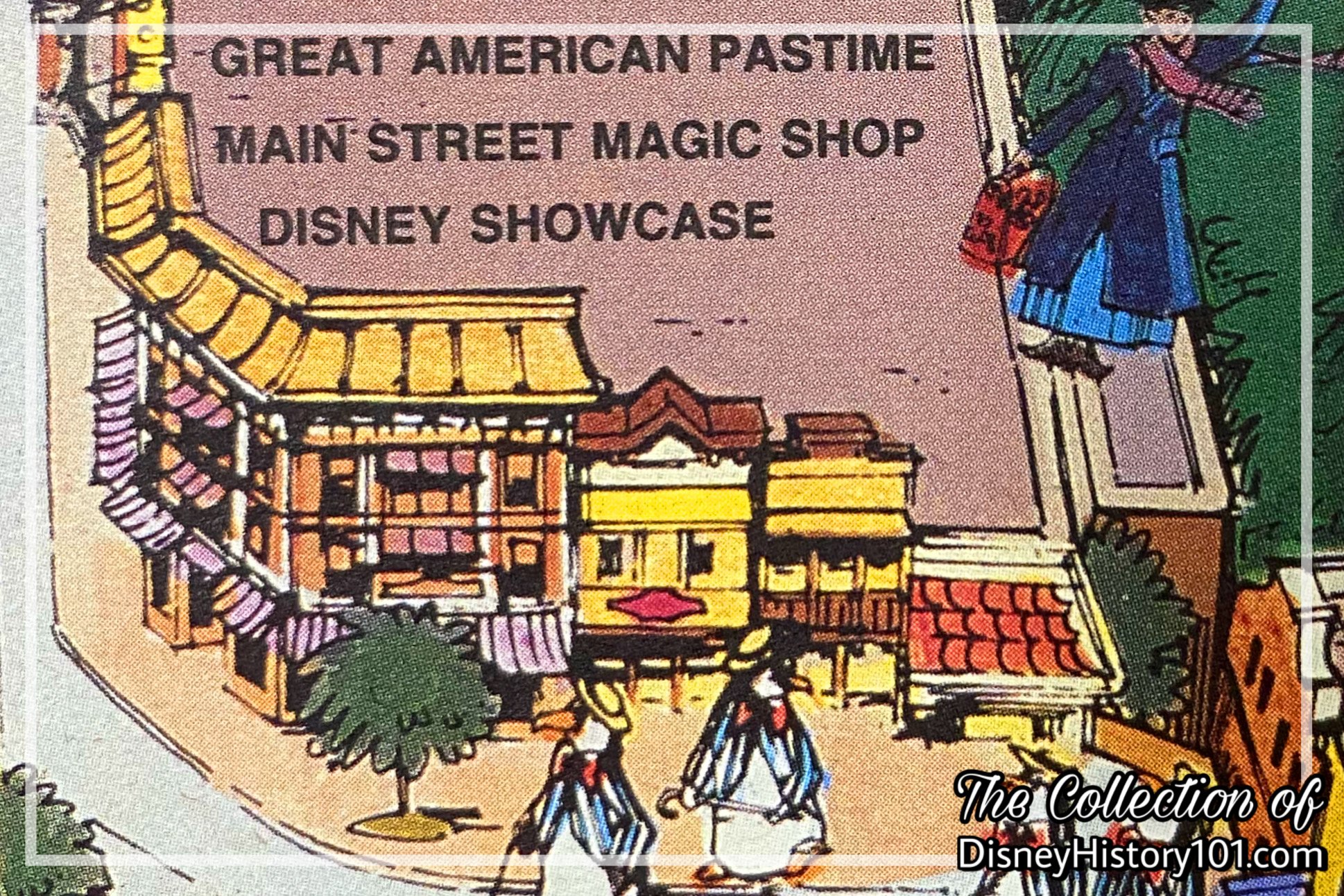
In 1989, the Disney Showcase shop opened, offering merchandise tied to Walt Disney motion pictures, television shows, and Disney Channel programs including “Who Framed Roger Rabbit, Chip ‘n’ Dale’s Rescue Rangers, The Little Mermaid, and The Mickey Mouse Club,” according to Disneyland Line (September 4, 1992; Vol.24, No.36). You may remember discovering mugs, t-shirts, and other merchandise featuring “Walt Disney Pictures’ Beauty and the Beast” or Earl Sinclair and the Baby from “Jim Henson’s Dinosaurs” at the Disney Showcase about this time.
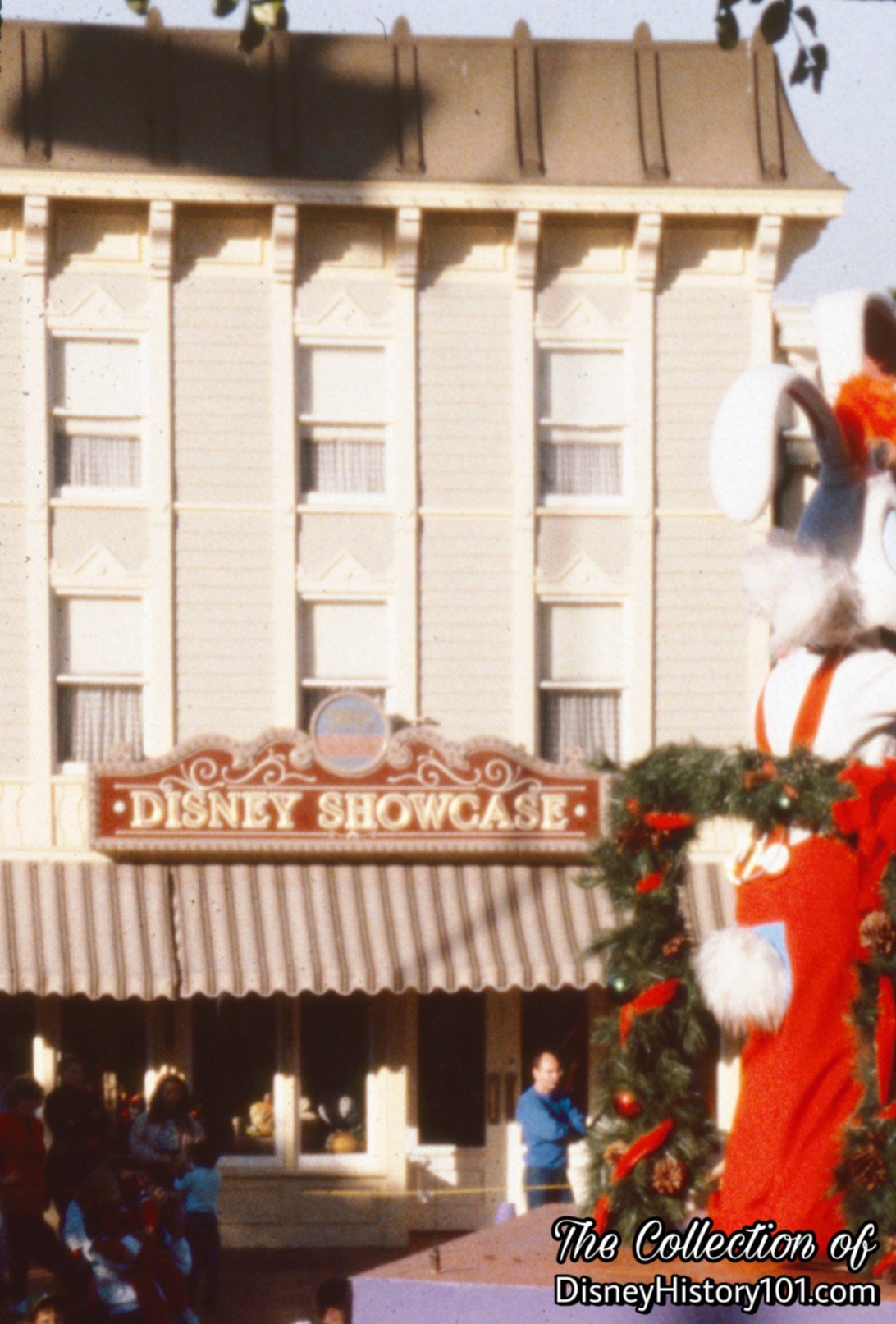
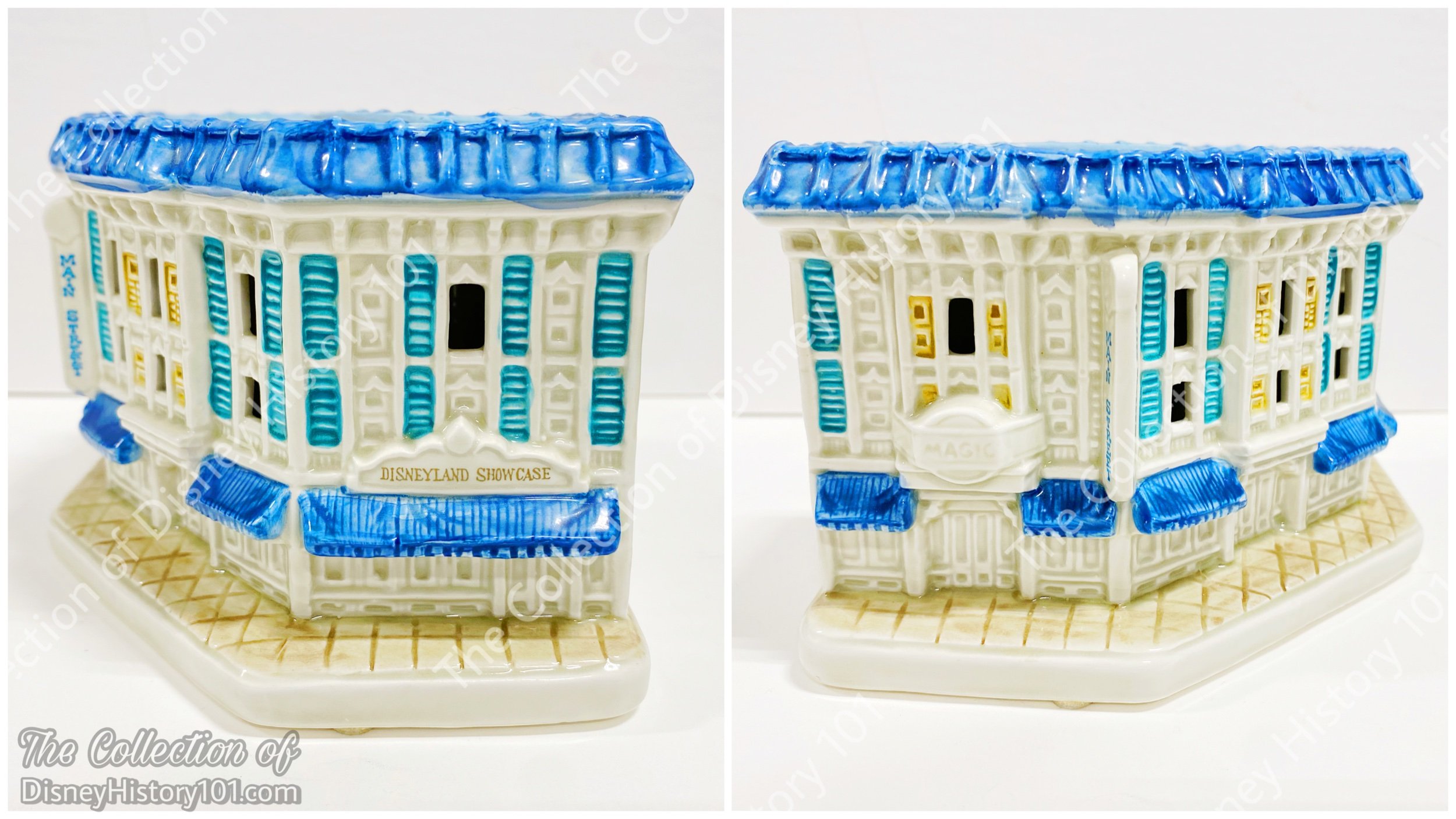

The location and design of the Wurlitzer building itself allowed it to be utilized for many different events. Trooper Lights and Camera men were often perched from the roof, as during the opening day parade in 1955, or Holiday Festivals of Disneyland’s “Fabulous First Decade.” During Disneyland’s American Bicentennial celebration of (1975 to 1976), Parade Coordinator Don Payne was stationed atop the former Wurlitzer building because it offered a great aerial view of the route and crowds. He recollects about this vantage : “The parade would step off and we would all have stop watches with lights, sound cues, and synchronized watches. I was on top of Wurlitzer when Hirohito visited and there was all kind of SWAT and security on the rooftops and in the crowds. The SWAT officer told me ‘If I say drop, you drop. If you don’t drop, I’ll have to shoot through you.’ They took guest security very seriously.” Long after the Wurlitzer name had departed from Main Street U.S.A., the rooftops of the former free exhibit became the site of free shows. During Circus Fantasy (1986), while the sounds of the circus calliope organ would pass through the street, High-Wire performance artists walked a tightrope which was connected to the former Wurlitzer building’s roof (pictured above).
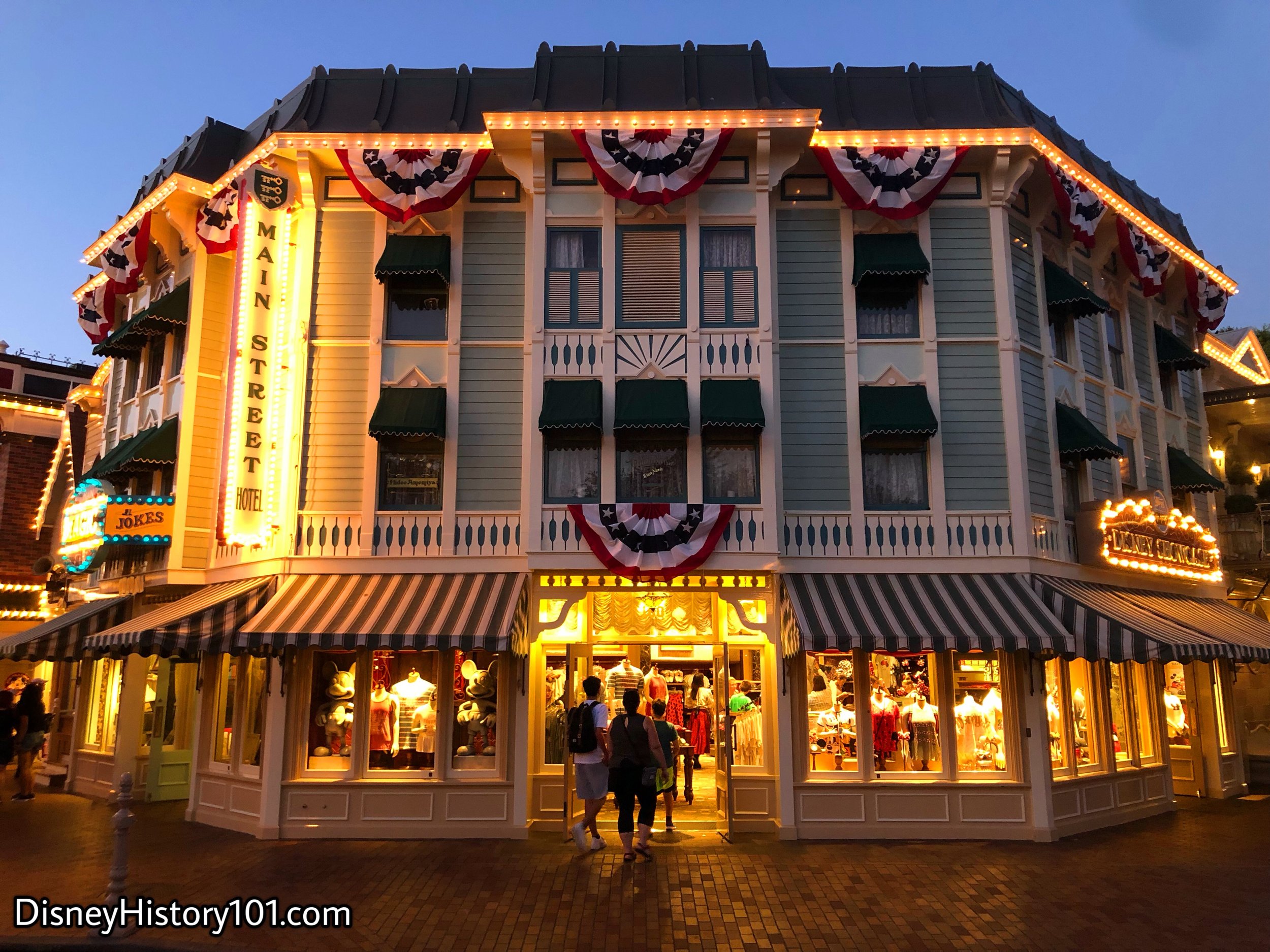
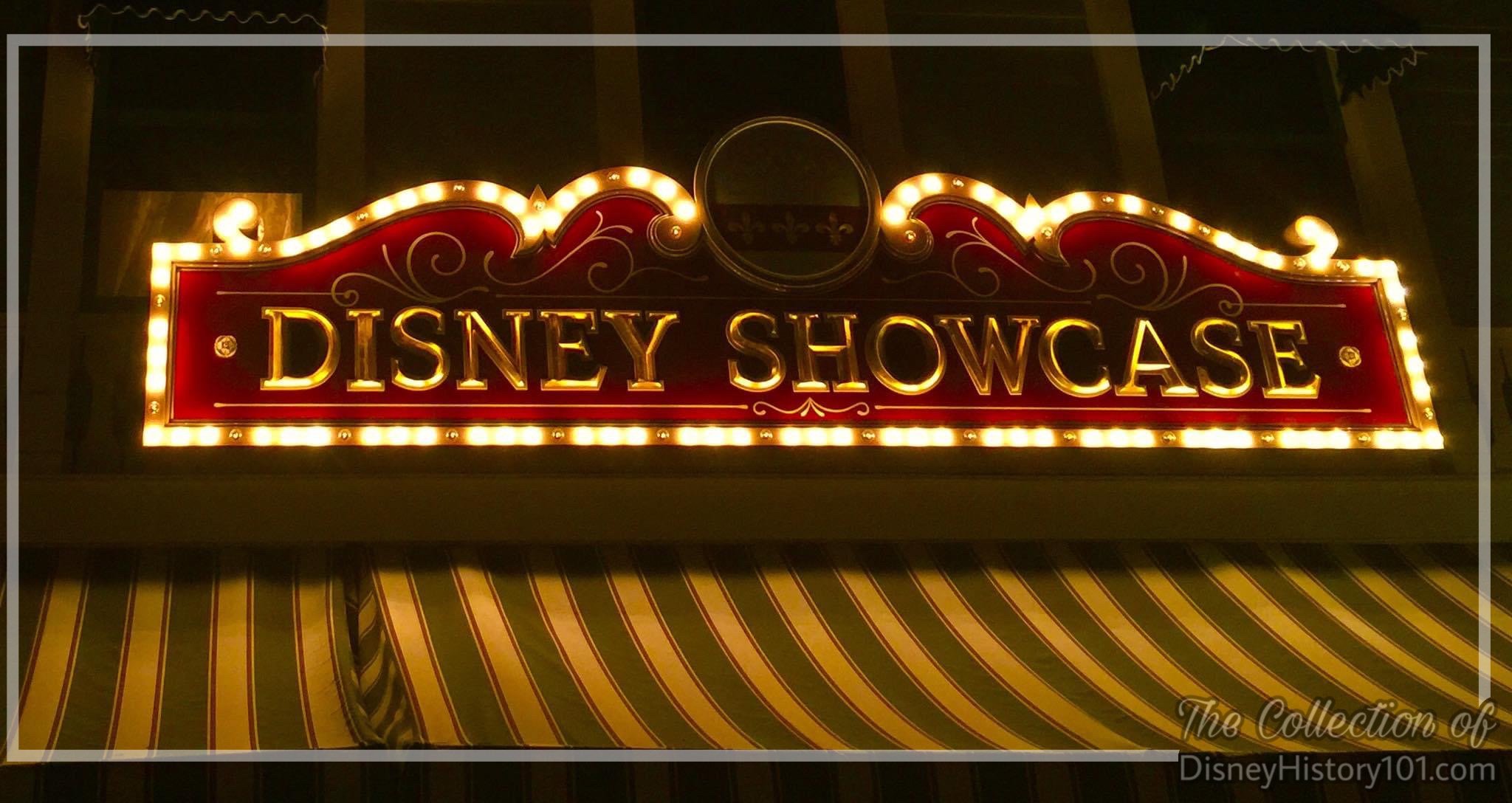
Well, it looks like we’ve come upon the old Wurlitzer corner store building as it stands today during the twilight hours - not a note of the previous exhibits or lessees. Currently, beneath the Main Street Hotel sits the Disney Showcase Shop - home of seasonal merchandise since 1989.
YALE TOWNE & LOCK SHOP
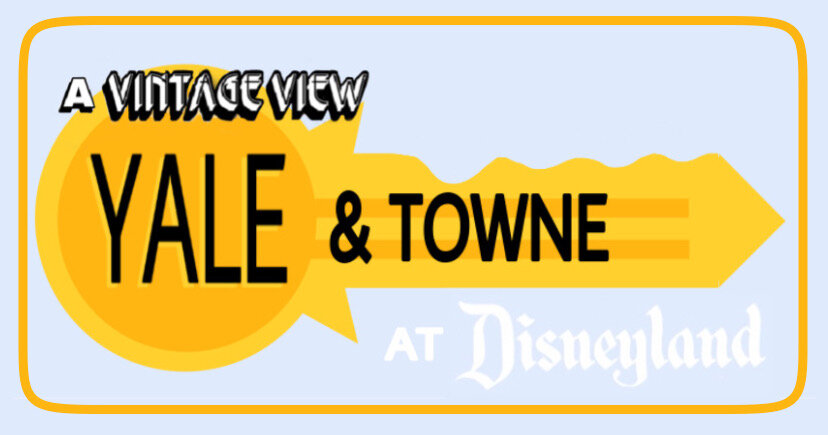
During 1954, Walt was searching for Participants (preferably, “old reliable firms, which have been in business fifty years or more”) to lease shop and restaurant spaces at Disneyland, and help generate the necessary capital to fund construction of Disneyland. By July 1, 1954, George Whitney of Disneyland, Inc. directed Amusements, with Ron Miller overseeing analysis, philosophy, capacities, planning, operator training, and amusement procurement. By July 1, 1954, Russel Tippett of Disneyland Inc. Advertising oversaw Exhibitor’s Space Sales and Lease Agreements. In a synergistic relationship, the companies (in turn) could sell their products and advertise their corporate names in the Park. Disneyland Participant Corporate Sponsors were carefully selected. High quality, long term corporate sponsors would provide incremental income that enabled Disneyland to enhance its show and attractions, offset some operating expenses, and capitalize on marketing opportunities.
Years later in 1958, Bank of America appraisers figured of the total income received from leases, 16.02% was derived from the selling of advertising rights and 40.12% from the leasing of space to concerns whose main reason for occupancy is for advertising purposes. The remaining 43.86% of the lease income was derived from stores that sell various products and food. Clearly these lessees would provide a certain level of income.
Yale Lock Manufacturing Company (founded in 1869, by Linus Yale Jr. and Henry Towne) was one of the United States’ “old reliable firms, which have been in business fifty years or more. Here they can show how they started and reproduce their first place of business.” [Disneyland Prospectus, 1954] As Walt described to Bob Thomas (of Associated Press), “some industries will have exhibits, but all of them must be in keeping with the era.”
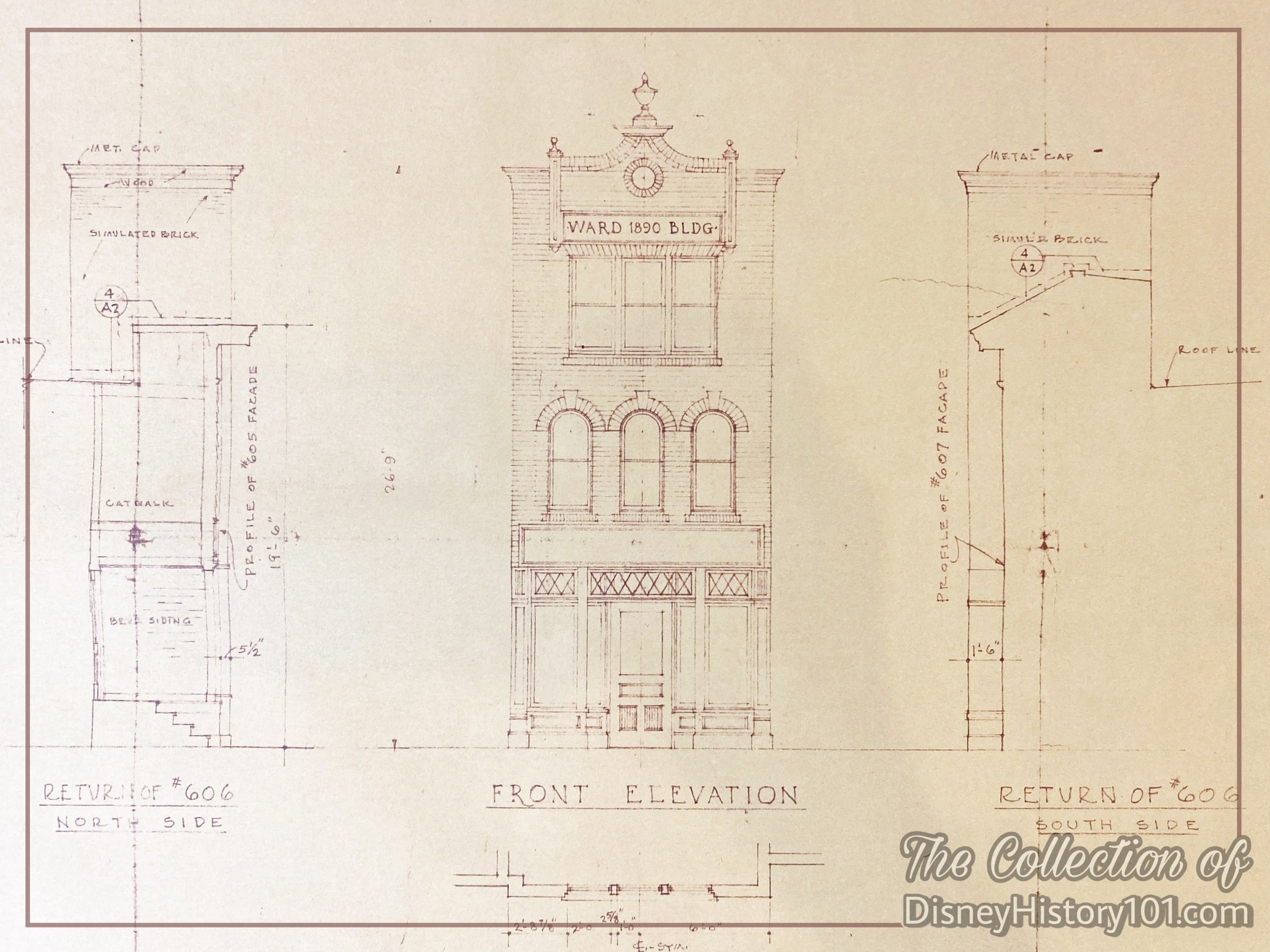
“Design”
In designing the Yale Lock Shop and the rest of Main Street, there was a lack of 20th-century architectural reference material at the time of the conception of Disneyland, so some Walt Disney Studio artist (Ward Kimball) made the contribution of rare books of drawings from his own collection. “Disneyland is unique in that some of the world's foremost creative artists and architects control all design at Disneyland.“ As early as 1953, artists Harper Goff, Herb Ryman, Sam McKim, Dale Hennesy, Harry Johnson (who was good friends with Herb Ryman, and whose designs were most influential), and others created many conceptual pieces for Main Street and it’s shops. Herb Ryman (who was an Illinois native, the same as Walt), “had a lot in common while discussing and developing Main Street” for the midwest visitors, according to “A Brush with Disney” by Herbert Ryman, page 148. Herb Ryman would create the first “Schematic Aerial View” over Disneyland (including Main Street USA), originally produced September 26 & 27, 1953.
Other contributing artists were model-maker Fred Joerger (who was hired c.1953 to craft the “Barber Shop Quartet” show for “Project Little Man” of “Walt Disney’s Disneyland”) and Wathel Rogers were instrumental in translating the two-dimensional artwork into detailed miniature models of Main Street. Their models explored the various dimensional relationships, site-lines, flow patterns, ergonomics, and visual appeal to convey the desired creative intent. On a leave of absence in 1954, Chuck Myall also joined WED to help create some of the Main Street facades.
Architectural drawings helped define all designs, production and construction strategies, costs, schedule, and resource requirements. A related lesser-known “Frock” is of particular note, for preparing the architectural elevation and floor plan drawings for the 600 Block of Main Street by February 19, 1955. His drawings were soon checked (by a “GMB”) and approved (by two individuals).
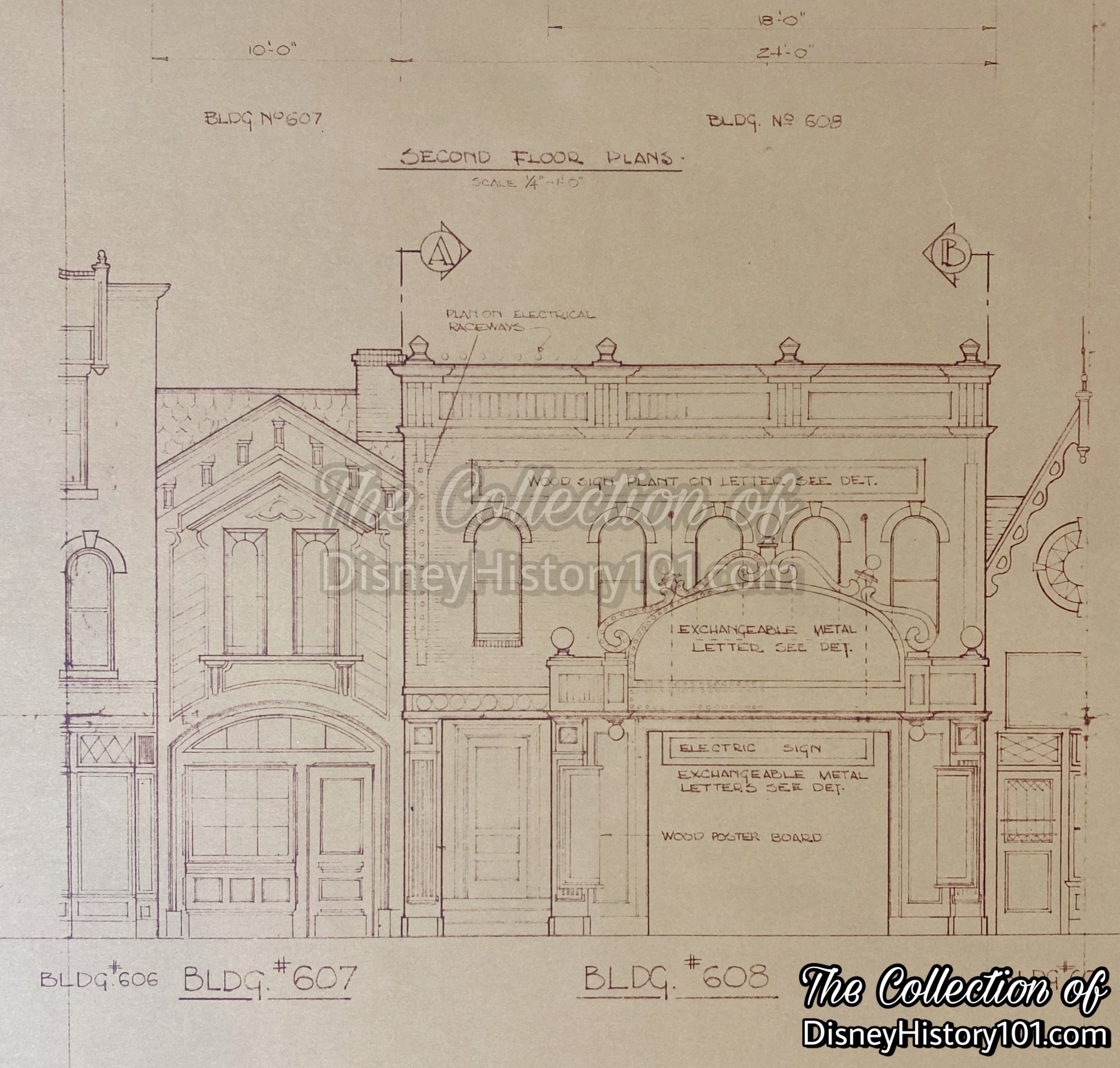
Drawn by Dean Tavoularis.
“Architectural Designs by Lessees”
Disneyland, Inc. printed materials for Lessees detailing specifications for architectural designs of exhibit spaces. These were revised by March 16, 1955 and issued to Lessees.
All of the interior architectural drawings were done by competent registered architects or an approved display house of the lessee's choice. All of the designs submitted by the lessee's architect, whether for buildings or construction of interiors in DISNEYLAND, were approved as to the theme and general plan of DISNEYLAND as established by WED Enterprises, Inc.
Three sets of preliminary drawings were furnished DISNEYLAND, Inc. as soon as possible after signing of the lease. Two sets were retained by DISNEYLAND and one set was returned to the lessee’s architect with any revisions noted thereon and stamped “APPROVAL TO PROCEED TO FINAL DESIGN.” This stamp when properly signed and dated constituted the lessee’s authority to proceed with the final drawings.
The Lessees revised their final drawings to incorporate any revisions noted on the approved preliminary drawings, and submitted three sets of the revised drawings to DISNEYLAND. One set was returned to the lessee’s architect and any revisions noted thereon are to be incorporated on the original drawings. When the lessee had incorporated the final revisions on the drawings, two sets of transparent ozalids were forwarded to DISNEYLAND for approval. DISNEYLAND would stamp both sets “FINAL DESIGN APPROVED” and “LESSEE’S CONTRACT DRAWINGS”, and return one set to the lessee who could then release drawings for bid and/or construction.
“Construction”
“When the giant earth-moving undertaking was completed, the building crews took over. Soon, the rat-tat-tat of riveters was shattering the air, and sparks were flying from welders’ torches as the steel frameworks, capable of withstanding the ravages of time and the elements rose above the newly formed ground. While carpenters hammered and masons laid row upon row of brick and stone and mortar, the permanent buildings began to take shape and form,” according to “The Disneyland Story” published 1955. One of the first buildings to be constructed was the Main Street Opera House, which was used as the Mill. Here, the woodwork of Disneyland was generated - from the functional to the aesthetic! Approximately three and one-half million board feet of lumber went into the Park’s construction. Much of the wood was processed here by McNeil Construction (which formerly constructed Walt Disney Studio sound stages in 1947 and 1953), and under the direction of George Mills Sr. (the Prime General Contractor and Mill Foreman). Then, under the direction of Joe Fowler (Construction Supervisor), as well as Charles Alexander and Ray Conway (Construction Field Supervisors), the lumber was soon fashioned into the framing belonging to the very first buildings constructed at Disneyland - primarily the Main Street Complexes (on each side of the street). This included Main Street Building #600 and the 329 square foot shop to be occupied by Yale & Towne.
F.M. Franz, manager of operations for MeNeil Construction expressed: "We feel sure there has never been anything built like this in Southern California, or elsewhere in the United States. Many of the items were constructed from artist’s sketches.” In constructing each building, a concrete foundation and slab floors were prepared, followed by wood frame construction (while store units would have a combination wood and rigid steel frame). ”The first fabricated steel for the Main Street buildings arrived November 8 and was erected,” according to the narrator of “Disneyland - The Park,” a Disneyland anthology television series excerpt, first aired 1957 and Disneyland LINE (November 22, 1979).
According to inserts published in area newspapers during July of 1955, Disney buildings were roofed by Pioneer Roof & Shingle Company (then located at 608 Mateo Street, Los Angeles, California; 7522 Westminster Avenue, Westminster, California). The roof covering was a variable, dependent on the architectural design.
Newbery Electric Corporation gave electricity to Disneyland. “The electrical installations were supervised by Roy J. Gruendler, manager of Newbery's Orange County district office located at 1335 Santiago Ave, Santa Ana.”
The building (as each on Main Street U.S.A.) possessed complete fire sprinkling systems. By June 30, 1955, related Disneyland Site Work Fire Protection Utilities Plot Plans were prepared for Disneyland Inc., by J.E. Thomasson of WED Enterprises Inc.
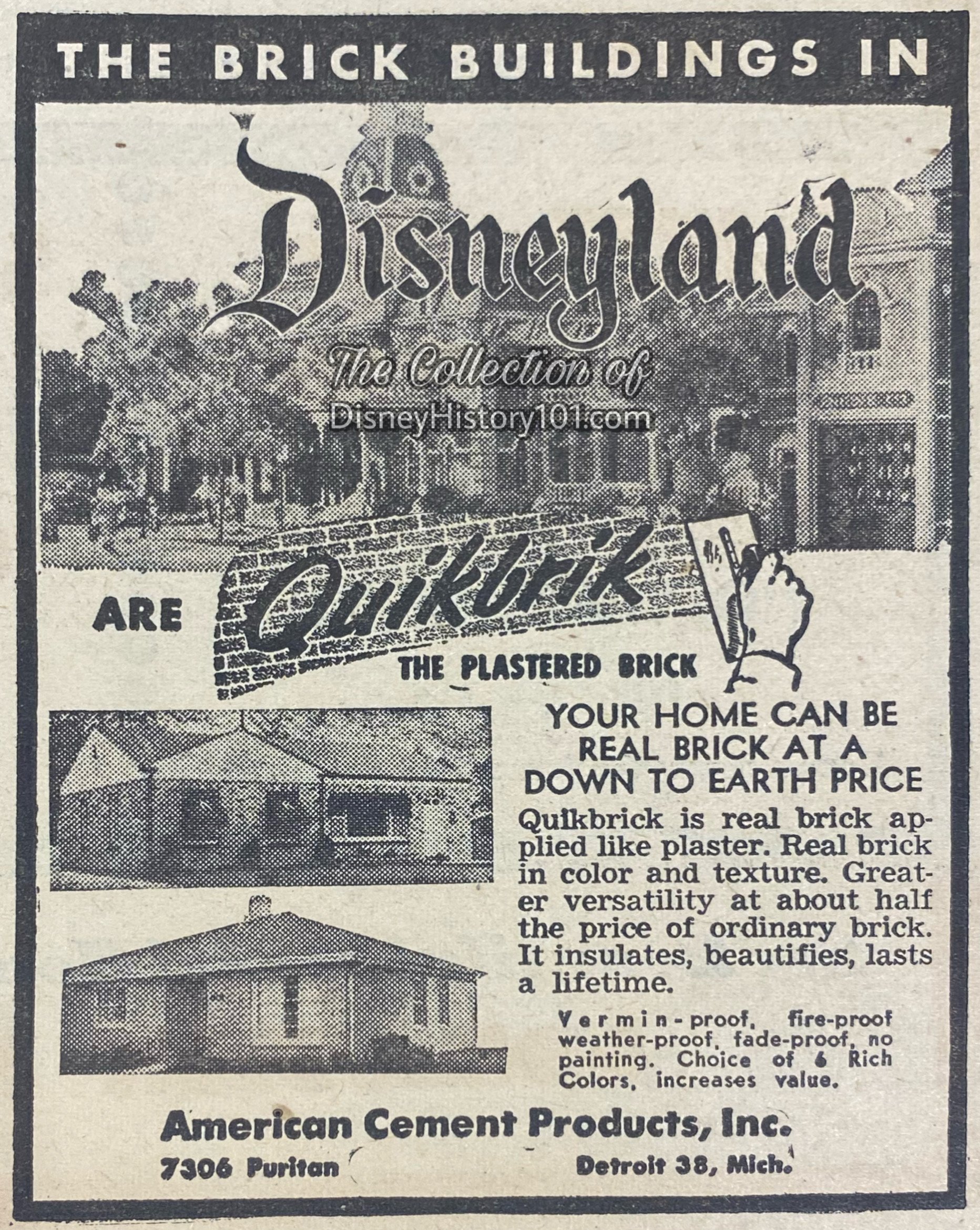
Larson Brothers Plastering Company of San Diego was a proud part of Disneyland. The company crafted the ornamental plastering and all brick used at Disneyland (including their amazing new plastered brick veneer). The versatile Quikbrick (real colorful and textural brick applied like plaster) was about half the price of ordinary brick. It insulated, beautified, and was meant to “last a lifetime.” It was used on the facade.
Ray Van de Warker (who became Department Manager of Office Support Services) remembered the distinct look of Main Street when he first came to work. “Main Street was dirt. Some of the buildings didn’t even have facades on.” (to Disneyland LINE, Vol.25, No.28, published July 16th, 1993). But soon the storefronts were erected. According to Florabel Muir (of the New York Daily News) divulged after a pre-opening (July 9th) tour by Walt, “the buildings are not false fronts as are seen on every studio backlot in Hollywood… Walking down Main Street, I saw a photographer’s shop, ice cream parlor, penny arcade, bakery, drug store, grocery and a butcher shop. These stores will be operated as concessions by well known U.S. firms. Swift & Co., for instance, will run the butcher shop, though instead of real pork, beef and lamb, they’ll sell candy imitations of their products.”
As with all of Disneyland’s Opening-Day landmarks, rides, and attractions, small local businesses provided materials, labor, and skills. Steel was provided by Triangle Steel & Supply Company (of Los Angeles).
All fixtures were placed in their correct motif and many light fixtures of Disneyland were authentic antiques. Newbery Electric Corporation “gave electricity to Disneyland,” Southern Counties Gas Company provided economical and clean gas, buildings were roofed by Pioneer Roof and Shingle Company (of Westminster, California), Mc Neil Construction Company provided labor, Evans and Reeves Landscaping Inc. (of West Los Angeles) achieved“the perfect landscape for Disneyland,” and so forth.
The buildings of Main Street (Yale & Towne Lock Shop included) were soon after described by an appraiser as “all very ornate, with variable embellishments. The basic construction, consists of concrete foundation and slab floors, wood frame construction, (store units also have a combination rigid steel frame) roof covering is variable, being dependant on architectural design. All buildings have complete fire sprinkling systems.” “Some of the cresting and railing to be seen in… Main Street came from old plantations in Nashville and Memphis, Tennessee. Other furnishings came from San Francisco, Oakland and Sacramento, dating back to the ‘49 gold rush days,” according to an article published in The Disneyland News (Vol.1 - No.1 ; July of 1955). [“Building A Dream”, Disneyland Public Relations Department]
As of June 2, 1955, C.V. Wood Jr. sent an Inter-Office Memorandum to Walt Disney regarding the best estimates that could be obtained at the time regarding the completion status of individual sections of the Park and Opening Day. C.V. wrote: “Building #606 - Yale & Towne: This one will be very close but we feel it will be completed. Electric Signs: All are in work - with the exception of the shoe store and the Bank of America, all will be completed.“
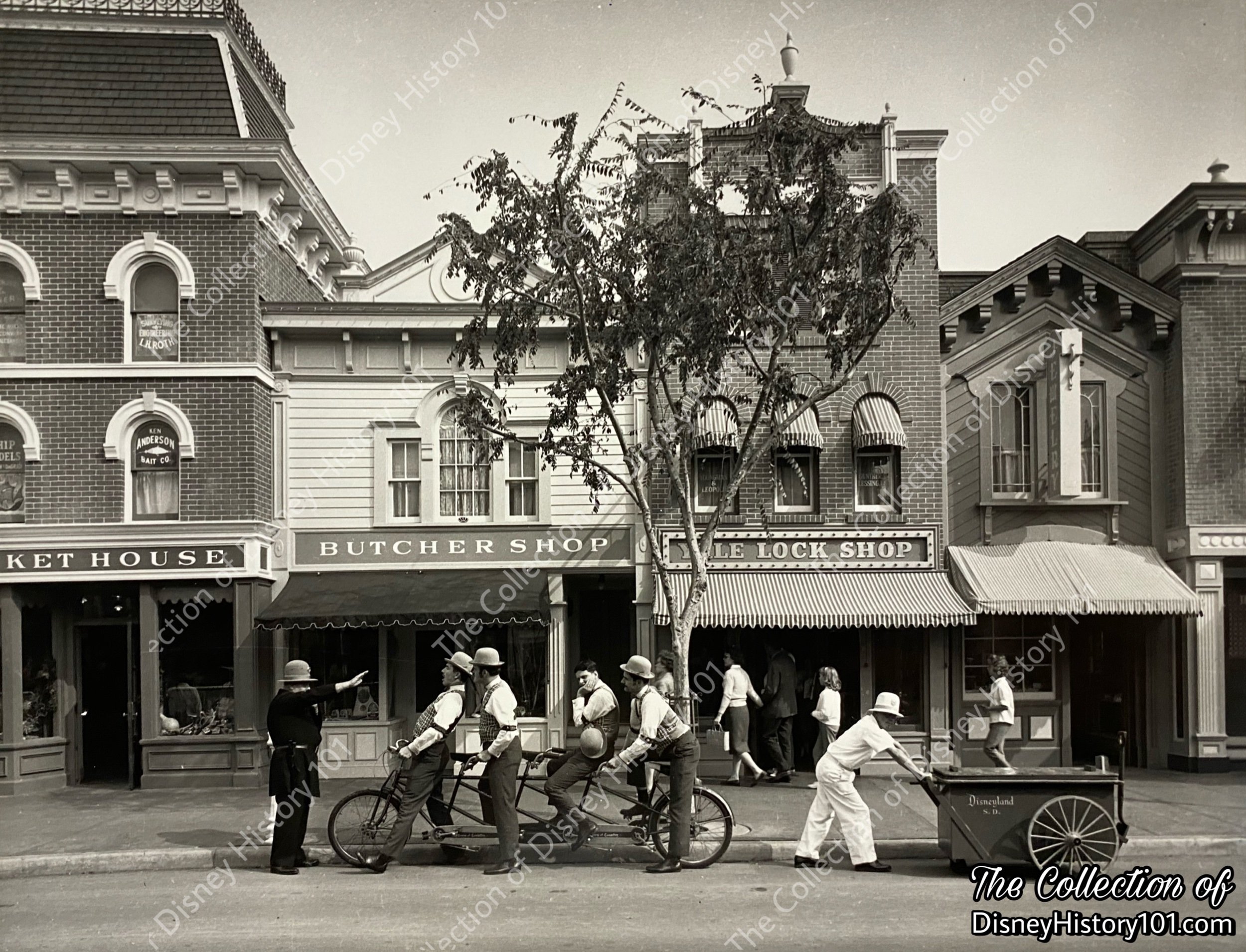
“Grand Opening”
Disneyland was a “new path” to explore for both Walt and Yale. The Yale and Towne Manufacturing Company attraction opened the Yale & Towne Lock Shop, at 606 Main Street, on Press Preview Day, July 17th, 1955. On that very Press Preview Day, the Yale brand was well represented at Disneyland. Yale tractors carried cameras and cameramen. Fess Parker bestowed a large Key to Disneyland (manufactured by Yale) upon Vice President Richard Nixon, Mrs. Nixon, and their daughters. The Yale & Towne Shop issued gold-plated Disneyland Souvenir Keys to members of the press and their families on July 17th, 1955.
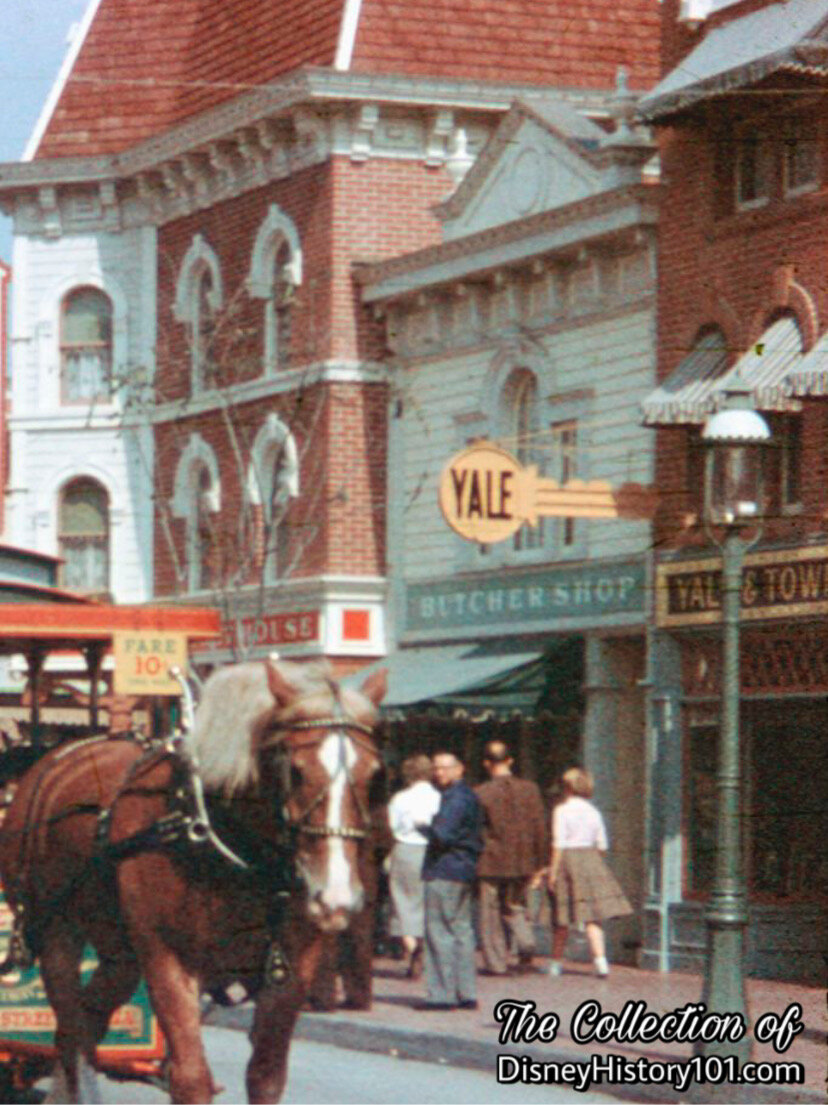

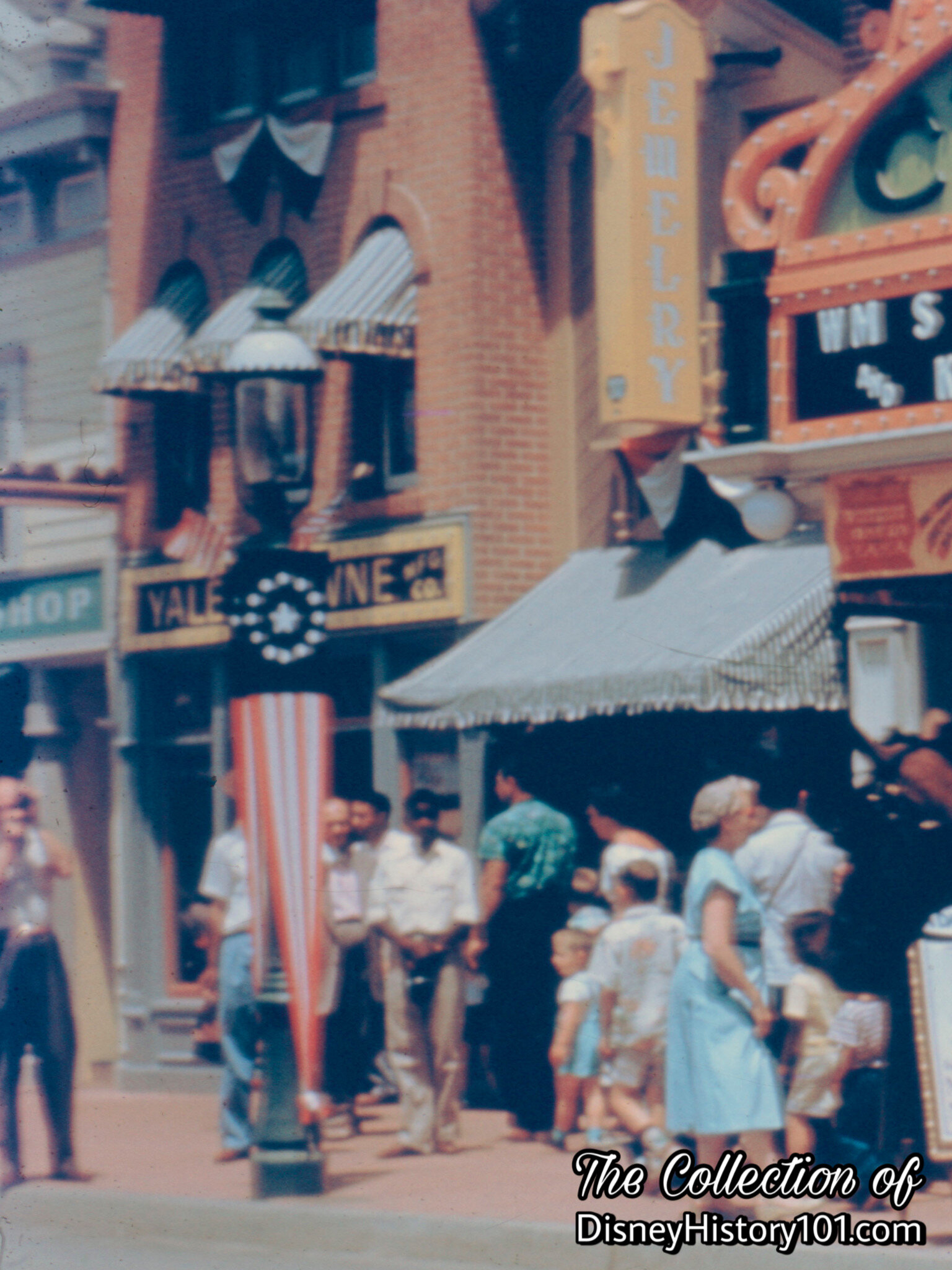
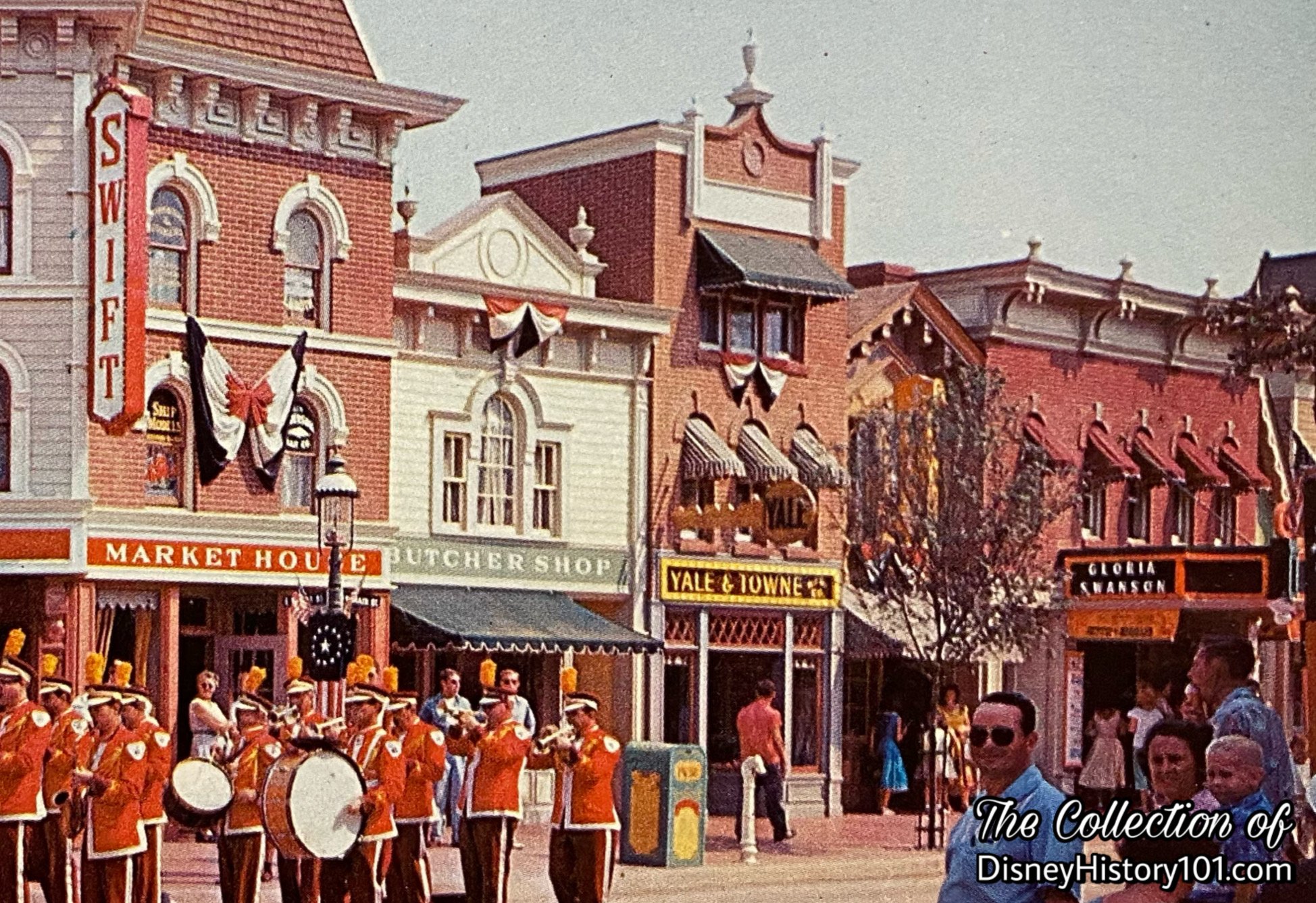
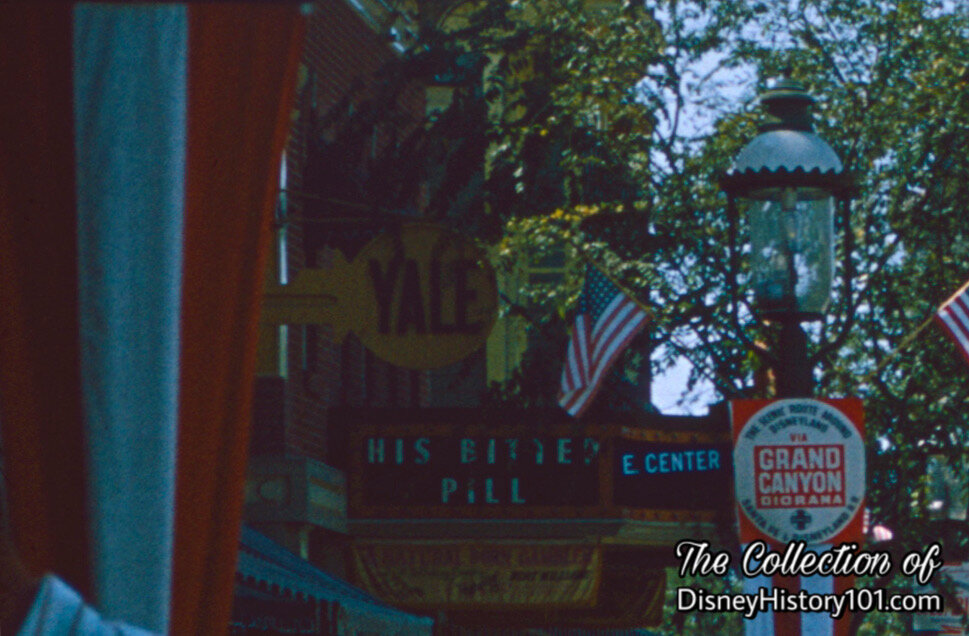
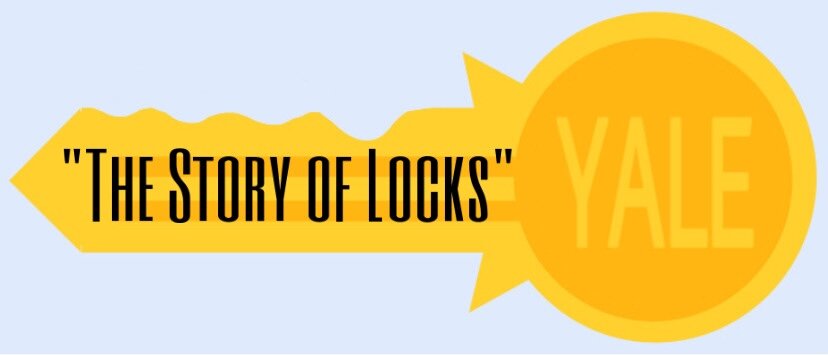
Now, “Disneyland is a place to have fun… and with the fun it is a place where you can learn… a place for people to find happiness and knowledge,” according to “Disneyland, U.S.A.” (published 1958, for potential Participants). Inside the relatively small 329 square-foot Yale & Towne Lock Shop was “The Story of Locks” exhibit, which featured a “complete display of the locksmith’s art” - both antique and modern locks. In short this was an exhibit showing the evolution of the lock and key down through the ages, and displayed many rare antique keys and locks.
According to one article published in “The Disneyland News” :
“Here, in a shop easily identified by the huge key swinging outside the entrance, the Yale Company has assembled one of the finest collections of assorted locks and keys on view anywhere in the western United States.
The story of locks goes all the way back, almost to the beginning of recorded history. The earliest forms known were used by the Egyptians some 5000 years ago. A reproduction of the ‘pin’ type lock found in the ruins of the ancient cities of the Nile hangs on one of the shop’s arresting display boards.
This lock was a crude but effective device that depended more on strength than on complexity in design for its operation. Greek lock was a tumbler type that used a sickle shaped instrument as a key.”
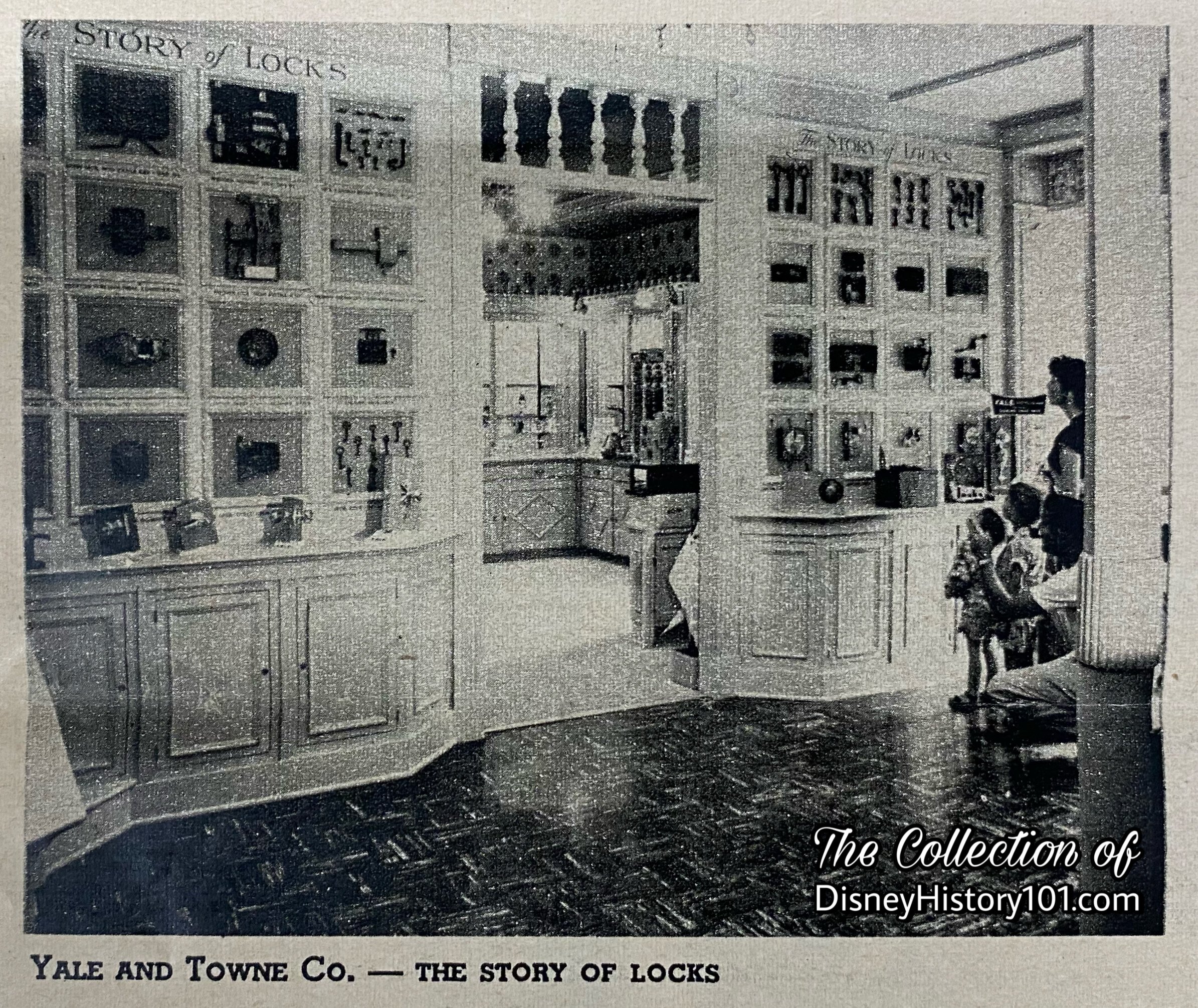
The same article of “The Disneyland News” continues:
“The Romans, improvers that they were, took elements of both earlier type locks and perfected the pin and tumbler lock, which used a more or less conventional type key. Keys that were actually used by the Romans - found in the ashes of the city that was Pompii - are on view here.
Medieval locks, such as the one that guarded a door in the famous German Trausemite Castle and dating from the 13th century, show the next major improvement in keys. This is the ‘warded’ type lock and key. This variety of lock, in use for several centuries until the development of the modern lock as patented by Linus Yale in 1861, was an intricate device that depended for its effect on the complexity of the pattern that could be worked into the design of the key.
One of the shop’s most interesting displays is an iron chest, forerunner of the modern day office safe. This specimen has a more romantic past than most of its type : the story is that it was in use on a pirate’s ship about the year 1700. Proof that honor among thieves was a chance thing is given by the fact that three keys are needed to gain access to the treasures it may have once contained. The captain and first and second mates carried keys, each one to one lock and the use of all three was necessary.”
As a “sidelight,” one of the best c.1956 interior images of Yale & Town Lock Shop can be found in "Homecoming - Destination Disneyland" by Carlene Thie with photos by Mel Kilpatrick. Considering all of these displays, it is easy to see why by the year 1958, the YALE Towne & Lock Shop was considered one of 15 free educational shows and exhibits at Disneyland.

The Disneyland News columnists regularly divulged when a Disneyland Participant was featured in an advertising campaign in another periodical. Once, when “Yale & Towne’s Street Shop was the subject of a full page four-color advertisement in several of the country’s leading periodical publications during the month of May,” it was written that the “Saturday Evening Post and TIME were two of the magazines that carried the striking ad which showed the store’s exterior.”
Articles and columns like this are a prime example of “the possibilities for a sponsor to capitalize on this association” with Disneyland. The many ways of “merchandising, sales promotion, advertising, public relations and publicity programs are almost limitless. Regardless of the type of product, goods or services manufactured and marketed by sponsors, the Disneyland association can be effectively and importantly translated into the sponsor’s promotional activities,” according to “Disneyland, U.S.A.,” published 1958.
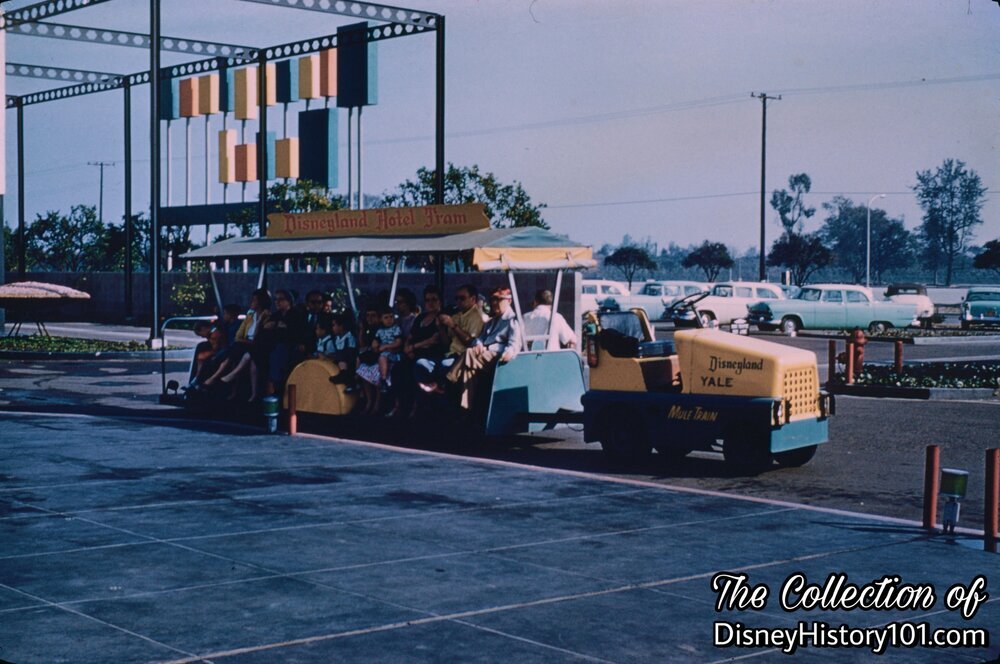
The Mule Trains - early tractors and trams - may have been designed by Bob Gurr, but they were manufactured by Yale. Yale was the very same manufacturer of the hydraulic YALE Forklifts used to swiftly transport cameras (situated atop platforms) for the Opening Day telecast. The Yale forklifts were powered by Chrysler Ind. 30 engines and could even maneuver cameras (and cameramen) to the height of forty feet in the air. More of these models were acquired on October 28, 1955 (at a cost of $4,527.40 and $4,363.26) to be utilized by both the Mill and Warehouse.
From 1955 to 1959, other forklift brands (e.g. Clark and Trojan) were purchased for use at both the Mill and Warehouse. However, Disneyland, Inc. also acquired a few YALE model G24 tractors (a total of 3 on July 29, 1955; valued at $1,250) to be utilized by the Warehouse and other locations.

Several of these “Mule Trains” and tractors can readily be seen preserved on film, in “Disneyland, U.S.A.” (a “People and Places” feature film, released in the U.S. on December 20, 1956 through Buena Vista Film Distribution Company). Brief footage of the original Mule Trains has also been amazingly preserved on film in the “An Adventure in the Magic Kingdom” episode of Walt Disney’s “Disneyland” television series (airing in 1958)!
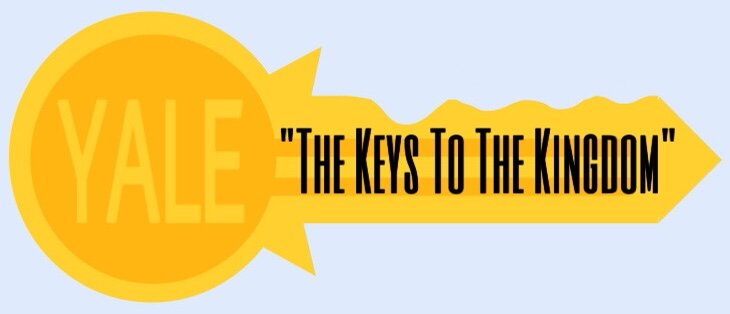
“I feel there is no door which with the kind of talent we have in our organization, could not be opened.” -Walt Disney.
While Disneyland occasionally made use of other brands (e.g. a $31 purchase from Kwikset Locks, Inc., during 1958), thousands of doors, locks, and plates with deadbolts installed around Disneyland (during the “first fabulous decade” and beyond) were manufactured by the Yale & Towne Manufacturing Company. These ranged from installation in Walt’s Firehouse Apartment to the Monsanto House of the Future and even the Haunted Mansion.
Before Disneyland opened, articles published in Pacific Coast Review and Printer’s Ink, mentioned that “Yale & Towne, lock shop… will give Disney a golden key that will open any lock in the park.“ Soon one Yale & Towne Manufacturing Company advertisement boasted : “Mr. Disney himself, like a magical Merlin, can open them all - many thousands of them - with a single Yale master key!”
This was further commented on in “Walt’s Master Key Opens All Magic Kingdom Doors” (published for guests in “The Disneyland News,” for November of 1955) : “One of the many wonders of Disneyland is a secret from the visiting public. This hidden wonder is the great grand master key system, created expressly by Yale & Towne locksmiths to provide the maximum in security and convenience in operating the thousands of locks that guard the Magic Kingdom’s valuable properties.
Within the ingenious key system only Walt Disney himself has the single ‘magic key.’ This is the grand master key that can open all of the thousands of different locks installed throughout the multi-million dollar funland.
This lone key is at the apex of the Yale master key system in which many thousands of locks are protecting both the public and Disneyland against loss or possible accident without interfering with the smooth operation of the par and its four major lands.
The unique master system begins with individual keys that can open only individual locks, continues to sub-master and grand master key levels, and all are unified by Walt’s single ‘magic’ key into a great grand master key system. This embraces all of the 160 acres of Disneyland, from the Turn-of-the-Centuy Main Street to Tomorrow and of 1986.
Watchmen, Maintenance and janitorial employees, however, who must service the shops, are assigned sub-master keys that will open the doors only on the blocks for which they are responsible. Thus Walt and his top aids don’t have to carry a pocket full of keys when visiting any part of Disneyland. His single key opens all the thousands of locks in the park.”
One of Walt’s “top aids,” Dorothy Wrigley (Walt’s Secretary, Park Operations Secretary & Disneyland’s 26th employee) helped set up (and regularly stock) Walt’s Main Street Apartment. This, Dorothy would do, before “Walt and Lilly would come to the Park to spend a few days in his apartment above the Fire Station,” according to “The Spirit of Disneyland” (published 1985, for Disneyland Cast Members). As with all of Disneyland’s c. 1955 keys, the special Yale Lock in the door accessing Walt’s Apartment could only be opened by a special Yale Key, which Walt (and evidently, Dorothy Wrigley) possessed.
You may recollect those “Day at Disneyland” Special Guest Cards which were once billed as “your ‘magic key’ that opens all the Doors in Walt Disney’s Magic Kingdom.” Perhaps Yale’s Master Key provided inspiration for this “tag line.”
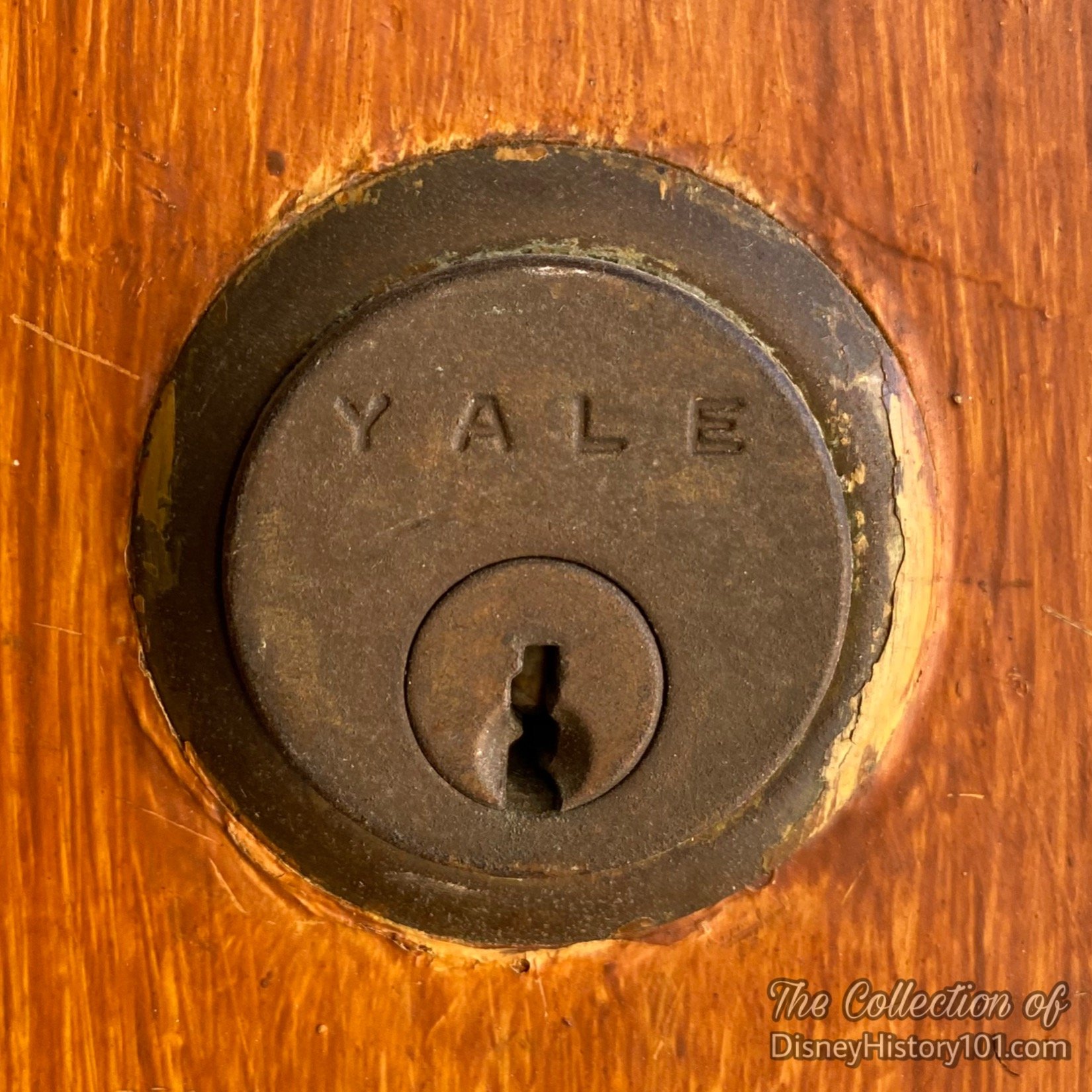
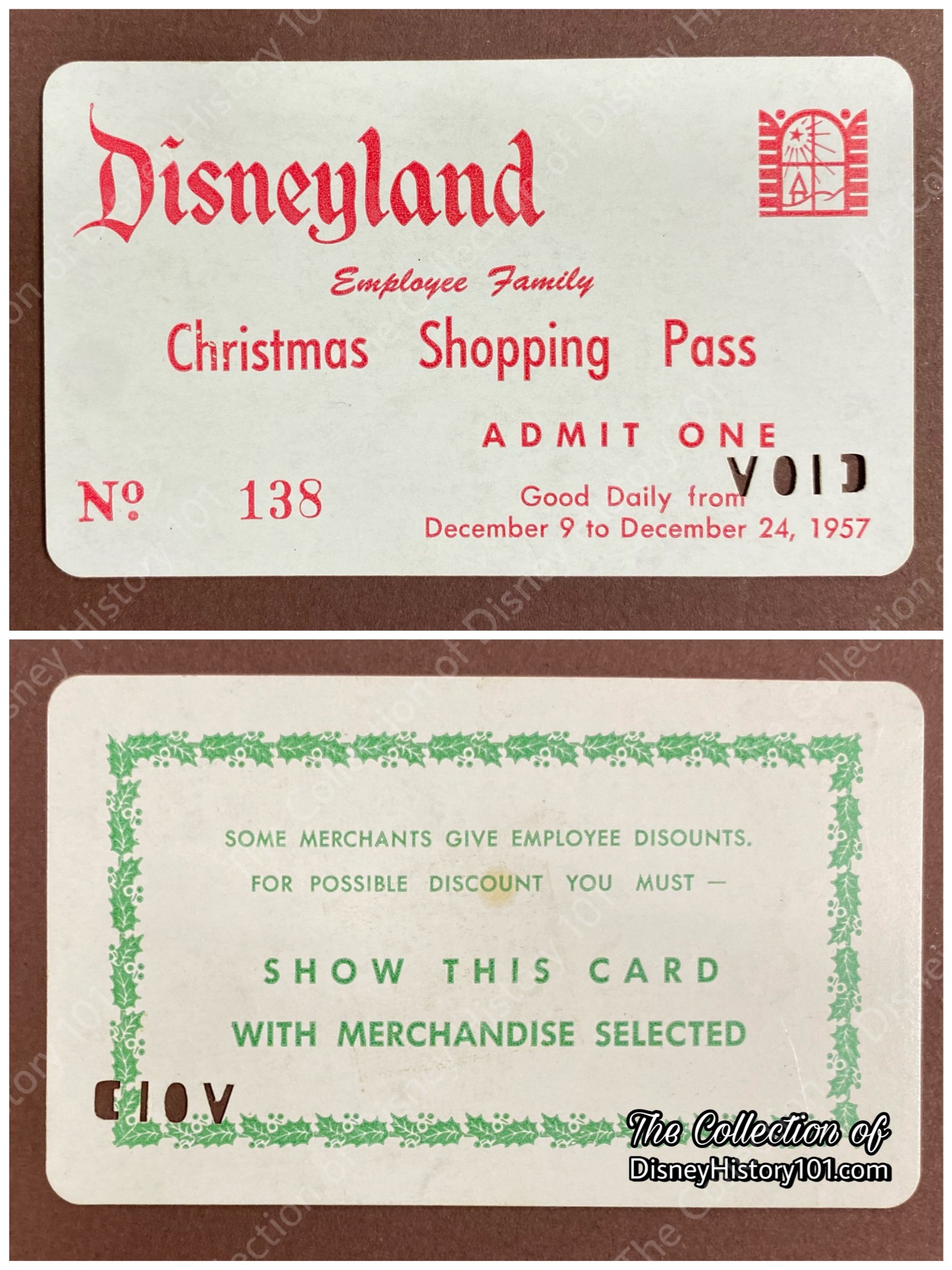
According to The Disneyland Shopper (published 1955): “Half the fun of buying Christmas Gifts is the atmosphere you shop in. You couldn't ask for more in the way of the spirit of Christmas than to shop in Disneyland. Especially along Main Street will you catch the air of the good old-fashioned Christmas with wreaths of holly, Christmas bells, carolers, snow-frosted windows gaily decorated with fairytale rhymes, and the scent of pine boughs in the air. Ringing through this Magic Kingdom are the Christmas Songs we all love to hear.”

Yale Lock Shop created tangible memories for Guests through Merchandise and Show. The “Disneyland 1st Anniversary Souvenir Pictorial,” encouraged visitors to “browse through stores whose shelves bulge with worlds of distinctive merchandise.” The Yale Lock Shop was not exempt, and addition to the Disneyland Keys, offered many other souvenirs, like souvenir keys and locks, and door knockers, and tie clasps and key chains with key motif. According to one article published in “The Disneyland News” : “Also available at the store is a variety of novel lock and key jewelry, including souvenir padlock earrings, key tie-clasps and cuff links. [Of course] Yale & Towne’s line of modern locks, both beautiful and functional, are also on view here. Combination locks, locks deigned for special uses - such as telephone locks - and a cutaway model of the modern pin and tumbler lock round out the store’s stock of items.”
The 1957 TWA brochure “Let’s Talk About… My Visit to Disneyland, Anaheim, California: A Note from Mary Gordon TWA Travel Advisor” mentioned: “We learned that to fully explore Disneyland takes two days, so early next morning we were at the gates of the park again. The second day we spent more time shopping in the 50 inviting shops, and the youngsters bought inexpensive souvenirs to take home to friends.”

Unlike the Upjohn Pharmacy exhibit, the Yale Lock Shop was not “merely a display store,” according to one article published in “The Disneyland News.” It offered a “practical key duplication service as part of the shop’s activity.” It is notable to mention that during these early years, it was commonplace for merchandise locations to stock General Merchandise - non -character and/or decorative items, including film and sundries.
Similar to other exhibits, souvenirs were made available. “These keys have a special Disneyland design showing the imprint of Sleeping Beauty’s Castle on the bow” and were “available only in the Main Street store.” All of these uncut keys were compatible with Yale home lock installations, and could thus be “cut” by your local locksmith. Advertisements for the “Souvenir Disneyland Key at the Yale Lock Shop” were run in issues of “The Disneyland News” (i.e. Vol.1, No.2 ; August, 1955).
These exclusive key “blanks” were routinely distributed as complimentary souvenirs over the years, and gifted on special occasions. For instance, Yale keys were given to invited members of the Press on Press Preview Day at Disneyland, on July 15, 1955. A special Yale “Key to Disneyland” was also presented to United States Vice President Richard Nixon by Fess Parker, on August 11, 1955.
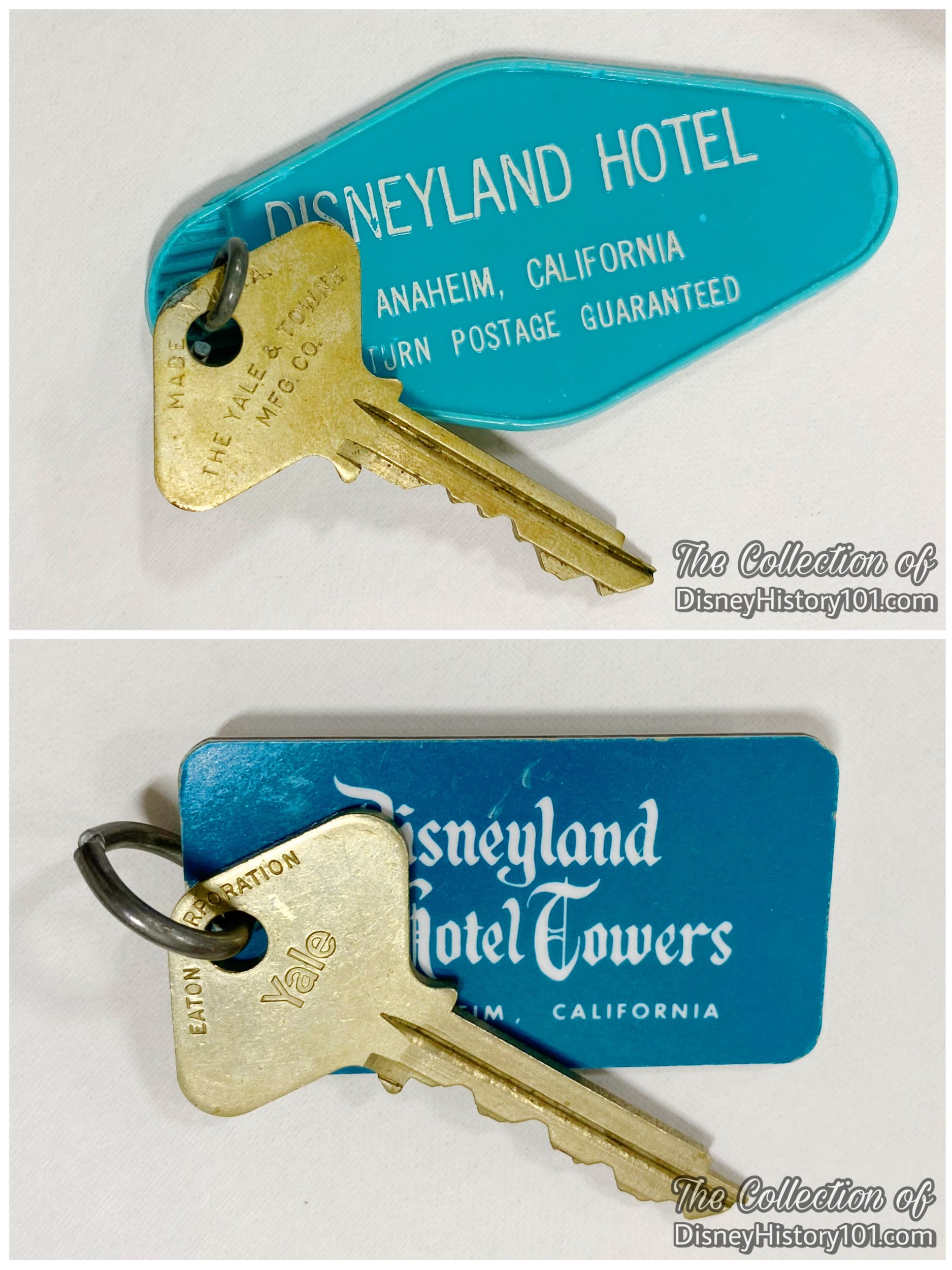
The Yale & Towne Manufacturing Company also first manufactured many of the keys for the locks belonging to the suites of the Disneyland Hotel. The Disneyland Hotel was distinguished from all other hotels on the west coast, in that its suites contained “the first installation of new Yale 5400 series cylindrical hotel locks.” The new knobs were “made of aluminum, strikingly finished with a satiny appearance,” and contained “internal parts of… brass and bronze for durability.” These locks also had the added privacy and safety feature of “a button in the center of the inside knob” which “causes two indicators to project from the center of the outside knob,” automatically locking the door and making it “impossible for the maid, housekeeper or even the manager with a master key to unlock the door from the outside… even other guest keys from the same room will not open the door.” However, the same article [of “The Disneyland News”] stated that, “For protection of guests, however, an emergency key is kept locked in the manager’s safe. The key will open the door to any room should a guest become incapacitated or other emergency occur.”

While a few other manufacturers, like Sargent would later also provide locks and keys for the Disneyland Hotel, Yale & Towne Manufacturing Company first primarily provided this service for Disneyland and the Disneyland Hotel.
The corporate synergy was good for a time. Institutional lessee the Yale and Town Manufacturing Company yielded some revenue for Disneyland Inc. - $4,847 for the fiscal year ending September 29, 1957 and $6,580 (in addition to estimated $77 in accounts receivable) for the fiscal year ending September 28, 1958.
By October of 1959, the company was (1) of over sixty-eight other firms playing a vital part in the team effort to bring happiness to Disneyland’s Guests. Some were small, specialized individual operators; some were huge companies such as Swift & Co. - the Bank of America - United Paramount Theaters (which you hear as UPT) - Carnation - Richfield - General Dynamics - Crane - and many others. These companies used the park to publicize their wares, leased space in the Park to sell their wares, and Disneyland collected advertising fees from them.
The doors of Yale Town & Locke at Disneyland were closed and locked for the final time in 1964.
“Keys & Key Control”
Today Key Control assists with keys or lock maintenance.
